class: center, middle <!-- make the interaction plots make more sense and relate to a question --> # When The Effect of One Predictor Depends on Another 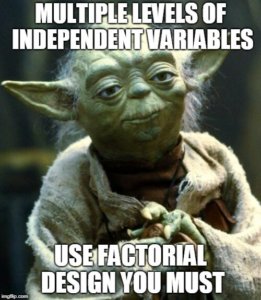 --- # The world isn't additive - Until now, we have assumed predictors combine additively - the effect of one is not dependent on the effect of the other -- - BUT - what if the effect of one variable depends on the level of another? -- - This is an **INTERACTION** and is quite common - Heck, a squared term is the interaction of a variable with itself! -- - Biology: The science of "It depends..." -- - This is challenging to think about and visualize, but if you can master it, you will go far! --- # We Have Explored Nonliearities Via Transforming our Response <img src="interactions_lm_files/figure-html/loglinear-1.png" style="display: block; margin: auto;" /> --- # But We Have Also Always Tested for Non-Additivity of Predictors <img src="interactions_lm_files/figure-html/unnamed-chunk-1-1.png" style="display: block; margin: auto;" /> --- # The Linear Model Can Accomodate Many Flavors of Nonlinearity `$$\hat{y_i} = \beta_0 + \beta_1 x_{1i} + \beta_2 x_{2i}$$` `$$y_i \sim N(\hat{y_i}, \sigma)$$` -- Could become... `$$\hat{y_i} = \beta_0 + \beta_1 x_{1i} + \beta_2 x_{1i}^2$$` -- Could be... `$$\hat{y_i} = \beta_0 + \beta_1 x_{1i} + \beta_2 x_{2i} + \beta_3 x_{1i}x_{2i}$$` -- .center[**It is ALL additive terms**] --- class: center, middle  --- # A Non-Additive World 1. Replicating Categorical Variable Combinations: Factorial Models 2. Evaluating Interaction Effects 3. How to Look at Means and Differences with an Interaction Effect 4. Continuous Variables and Interaction Effects --- # Intertidal Grazing! .center[ 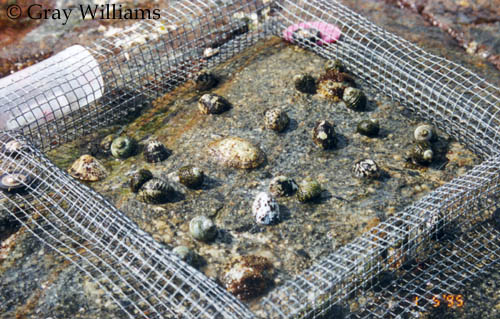 #### Do grazers reduce algal cover in the intertidal? ] --- # Experiment Replicated on Two Ends of a gradient 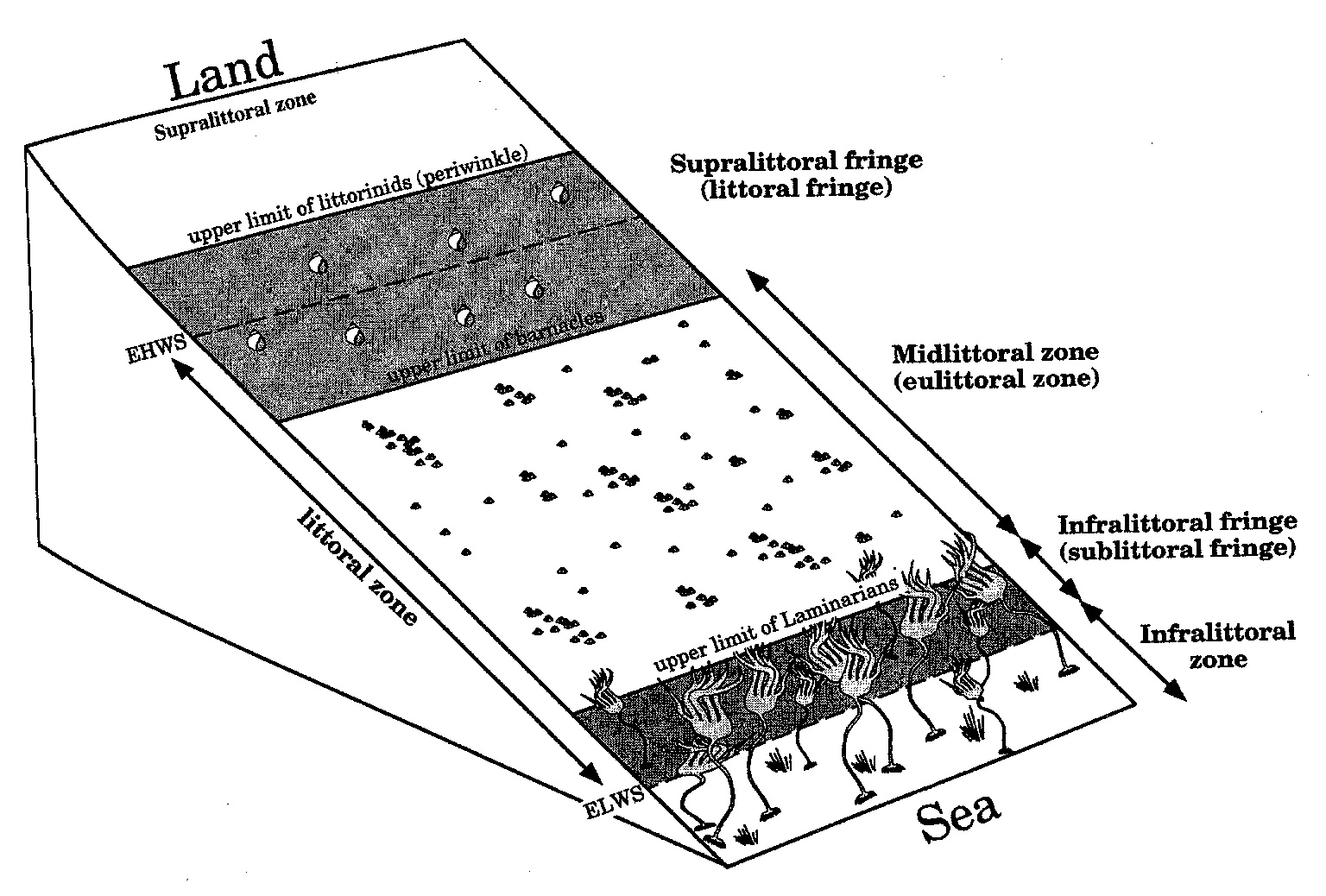 --- # Factorial Experiment 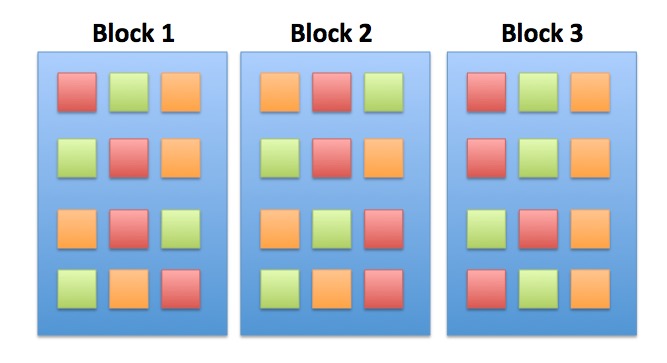 --- # Factorial Design 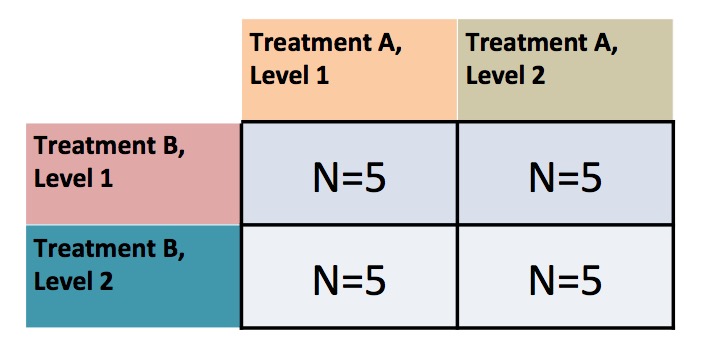 Note: You can have as many treatment types or observed category combinations as you want (and then 3-way, 4-way, etc. interactions) --- # The Data: See the dependency of one treatment on another? <img src="interactions_lm_files/figure-html/plot_algae-1.png" style="display: block; margin: auto;" /> --- # If we had fit y ~ a + b, residuals look weird <img src="interactions_lm_files/figure-html/graze_assumptions-1.png" style="display: block; margin: auto;" /> --- # A Factorial Model `$$\large y_{ijk} = \beta_{0} + \sum \beta_{i}x_{i} + \sum \beta_{j}x_{j} + \sum \beta_{ij}x_{ij} + \epsilon_{ijk}$$` `$$\large \epsilon_{ijk} \sim N(0, \sigma^{2} )$$` `$$\large x_{i} = 0,1, x_{j} = 0,1, x_{ij} = 0,1$$` -- - Note the new last term -- - Deviation due to *combination of categories i and j* -- <hr> This is still something that is in `$$\Large \boldsymbol{Y} = \boldsymbol{\beta X} + \boldsymbol{\epsilon}$$` --- # The Data (Four Rows) <table class="table table-striped" style="color: black; margin-left: auto; margin-right: auto;"> <thead> <tr> <th style="text-align:left;"> height </th> <th style="text-align:left;"> herbivores </th> <th style="text-align:right;"> sqrtarea </th> </tr> </thead> <tbody> <tr> <td style="text-align:left;"> low </td> <td style="text-align:left;"> minus </td> <td style="text-align:right;"> 9.4055728 </td> </tr> <tr> <td style="text-align:left;"> low </td> <td style="text-align:left;"> plus </td> <td style="text-align:right;"> 11.9767608 </td> </tr> <tr> <td style="text-align:left;"> mid </td> <td style="text-align:left;"> minus </td> <td style="text-align:right;"> 0.7071068 </td> </tr> <tr> <td style="text-align:left;"> mid </td> <td style="text-align:left;"> plus </td> <td style="text-align:right;"> 0.7071068 </td> </tr> </tbody> </table> --- # The Dummy-Coded Treatment Contrasts <table class="table table-striped" style="color: black; margin-left: auto; margin-right: auto;"> <thead> <tr> <th style="text-align:right;"> (Intercept) </th> <th style="text-align:right;"> heightmid </th> <th style="text-align:right;"> herbivoresplus </th> <th style="text-align:right;"> heightmid:herbivoresplus </th> </tr> </thead> <tbody> <tr> <td style="text-align:right;"> 1 </td> <td style="text-align:right;"> 0 </td> <td style="text-align:right;"> 0 </td> <td style="text-align:right;"> 0 </td> </tr> <tr> <td style="text-align:right;"> 1 </td> <td style="text-align:right;"> 0 </td> <td style="text-align:right;"> 1 </td> <td style="text-align:right;"> 0 </td> </tr> <tr> <td style="text-align:right;"> 1 </td> <td style="text-align:right;"> 1 </td> <td style="text-align:right;"> 0 </td> <td style="text-align:right;"> 0 </td> </tr> <tr> <td style="text-align:right;"> 1 </td> <td style="text-align:right;"> 1 </td> <td style="text-align:right;"> 1 </td> <td style="text-align:right;"> 1 </td> </tr> </tbody> </table> --- # Fitting with Least Squares ``` r graze_int <- lm(sqrtarea ~ height + herbivores + height:herbivores, data=algae) ## OR graze_int <- lm(sqrtarea ~ height*herbivores, data=algae) ``` --- # Now We Are Linear/Additive <img src="interactions_lm_files/figure-html/unnamed-chunk-2-1.png" style="display: block; margin: auto;" /> --- # Residuals A-OK <img src="interactions_lm_files/figure-html/unnamed-chunk-3-1.png" style="display: block; margin: auto;" /> --- # HOV Good! <img src="interactions_lm_files/figure-html/unnamed-chunk-4-1.png" style="display: block; margin: auto;" /> --- # No Outliers <img src="interactions_lm_files/figure-html/unnamed-chunk-5-1.png" style="display: block; margin: auto;" /> --- # Collinearity is Tricky - unimportant for interaction <img src="interactions_lm_files/figure-html/unnamed-chunk-6-1.png" style="display: block; margin: auto;" /> --- # A Non-Additive World 1. Replicating Categorical Variable Combinations: Factorial Models 2. .red[ Evaluating Interaction Effects ] 3. How to Look at Means and Differences with an Interaction Effect 4. Continuous Variables and Interaction Effects --- # What do the Coefficients Mean? <table class="table table-striped" style="color: black; margin-left: auto; margin-right: auto;"> <thead> <tr> <th style="text-align:left;"> term </th> <th style="text-align:right;"> estimate </th> <th style="text-align:right;"> std.error </th> </tr> </thead> <tbody> <tr> <td style="text-align:left;"> (Intercept) </td> <td style="text-align:right;"> 32.91450 </td> <td style="text-align:right;"> 3.855532 </td> </tr> <tr> <td style="text-align:left;"> heightmid </td> <td style="text-align:right;"> -10.43090 </td> <td style="text-align:right;"> 5.452546 </td> </tr> <tr> <td style="text-align:left;"> herbivoresplus </td> <td style="text-align:right;"> -22.51075 </td> <td style="text-align:right;"> 5.452546 </td> </tr> <tr> <td style="text-align:left;"> heightmid:herbivoresplus </td> <td style="text-align:right;"> 25.57809 </td> <td style="text-align:right;"> 7.711064 </td> </tr> </tbody> </table> -- - Intercept chosen as basal condition (low, herbivores -) -- - Changing height to mid is associated with a loss of 10 units of algae relative to low/- -- - Adding herbivores is associated with a loss of 22 units of algae relative to low/- -- - BUT - if you add herbivores and mid, that's also associated with an additional increase of 25 units of algae relative to mid and + alone - 25.5 - 22.5 - 10.4 = only a loss of 7.4 relative to low/- --- # What do the Coefficients Mean? <table class="table table-striped" style="color: black; margin-left: auto; margin-right: auto;"> <thead> <tr> <th style="text-align:left;"> term </th> <th style="text-align:right;"> estimate </th> <th style="text-align:right;"> std.error </th> </tr> </thead> <tbody> <tr> <td style="text-align:left;"> (Intercept) </td> <td style="text-align:right;"> 32.91450 </td> <td style="text-align:right;"> 3.855532 </td> </tr> <tr> <td style="text-align:left;"> heightmid </td> <td style="text-align:right;"> -10.43090 </td> <td style="text-align:right;"> 5.452546 </td> </tr> <tr> <td style="text-align:left;"> herbivoresplus </td> <td style="text-align:right;"> -22.51075 </td> <td style="text-align:right;"> 5.452546 </td> </tr> <tr> <td style="text-align:left;"> heightmid:herbivoresplus </td> <td style="text-align:right;"> 25.57809 </td> <td style="text-align:right;"> 7.711064 </td> </tr> </tbody> </table> <br><br> .center[**NEVER TRY AND INTERPRET ADDITIVE EFFECTS ALONE WHEN AN INTERACTION IS PRESENT**<Br>that way lies madness] --- # This view is intuitive <img src="interactions_lm_files/figure-html/unnamed-chunk-7-1.png" style="display: block; margin: auto;" /> --- # This view is also intuitive <img src="interactions_lm_files/figure-html/unnamed-chunk-8-1.png" style="display: block; margin: auto;" /> --- # We Can Still Look at R^2 ``` # R2 for Linear Regression R2: 0.228 adj. R2: 0.190 ``` Eh, not great, not bad... -- - Note: adding more interaction effects will always increase the R<sup>2</sup> so only add if warranted - NO FISHING! --- # A Non-Additive World 1. Replicating Categorical Variable Combinations: Factorial Models 2. Evaluating Interaction Effects 3. .red[ How to Look at Means and Differences with an Interaction Effect ] 4. Continuous Variables and Interaction Effects --- # Posthoc Estimated Means and Interactions with Categorical Variables - Must look at **simple effects** first in the presence of an interaction - The effects of individual treatment combinations - If you have an interaction, this is what you do! -- - **Main effects describe effects of one variable in the absence of an interaction** - Useful only if there is no interaction - Or useful if one categorical variable can be absent --- # Estimated Means with No Interaction - Misleading! ``` herbivores emmean SE df lower.CL upper.CL minus 27.7 2.73 60 22.2 33.2 plus 18.0 2.73 60 12.5 23.4 Results are averaged over the levels of: height Confidence level used: 0.95 ``` ``` height emmean SE df lower.CL upper.CL low 21.7 2.73 60 16.2 27.1 mid 24.0 2.73 60 18.6 29.5 Results are averaged over the levels of: herbivores Confidence level used: 0.95 ``` --- # Posthoc Comparisons Averaging Over Blocks - Misleading! ``` contrast estimate SE df lower.CL upper.CL minus - plus 9.72 3.86 60 2.01 17.4 Results are averaged over the levels of: height Confidence level used: 0.95 ``` --- # Simple Effects Means ``` height herbivores emmean SE df lower.CL upper.CL low minus 32.9 3.86 60 25.20 40.6 mid minus 22.5 3.86 60 14.77 30.2 low plus 10.4 3.86 60 2.69 18.1 mid plus 25.6 3.86 60 17.84 33.3 Confidence level used: 0.95 ``` --- # Posthoc with Simple Effects <table class="table table-striped" style="color: black; margin-left: auto; margin-right: auto;"> <thead> <tr> <th style="text-align:left;"> contrast </th> <th style="text-align:right;"> estimate </th> <th style="text-align:right;"> SE </th> <th style="text-align:right;"> df </th> <th style="text-align:right;"> t.ratio </th> <th style="text-align:right;"> p.value </th> </tr> </thead> <tbody> <tr> <td style="text-align:left;"> low minus - mid minus </td> <td style="text-align:right;"> 10.430905 </td> <td style="text-align:right;"> 5.452546 </td> <td style="text-align:right;"> 60 </td> <td style="text-align:right;"> 1.913034 </td> <td style="text-align:right;"> 0.0605194 </td> </tr> <tr> <td style="text-align:left;"> low minus - low plus </td> <td style="text-align:right;"> 22.510748 </td> <td style="text-align:right;"> 5.452546 </td> <td style="text-align:right;"> 60 </td> <td style="text-align:right;"> 4.128484 </td> <td style="text-align:right;"> 0.0001146 </td> </tr> <tr> <td style="text-align:left;"> low minus - mid plus </td> <td style="text-align:right;"> 7.363559 </td> <td style="text-align:right;"> 5.452546 </td> <td style="text-align:right;"> 60 </td> <td style="text-align:right;"> 1.350481 </td> <td style="text-align:right;"> 0.1819337 </td> </tr> <tr> <td style="text-align:left;"> mid minus - low plus </td> <td style="text-align:right;"> 12.079843 </td> <td style="text-align:right;"> 5.452546 </td> <td style="text-align:right;"> 60 </td> <td style="text-align:right;"> 2.215450 </td> <td style="text-align:right;"> 0.0305355 </td> </tr> <tr> <td style="text-align:left;"> mid minus - mid plus </td> <td style="text-align:right;"> -3.067346 </td> <td style="text-align:right;"> 5.452546 </td> <td style="text-align:right;"> 60 </td> <td style="text-align:right;"> -0.562553 </td> <td style="text-align:right;"> 0.5758352 </td> </tr> <tr> <td style="text-align:left;"> low plus - mid plus </td> <td style="text-align:right;"> -15.147189 </td> <td style="text-align:right;"> 5.452546 </td> <td style="text-align:right;"> 60 </td> <td style="text-align:right;"> -2.778003 </td> <td style="text-align:right;"> 0.0072896 </td> </tr> </tbody> </table> -- .center[**That's a Lot to Drink In!**] --- # Might be easier visually <img src="interactions_lm_files/figure-html/graze_posthoc_plot-1.png" style="display: block; margin: auto;" /> --- # We are often interested in looking at differences within levels... ``` height = low: herbivores emmean SE df lower.CL upper.CL minus 32.9 3.86 60 25.20 40.6 plus 10.4 3.86 60 2.69 18.1 height = mid: herbivores emmean SE df lower.CL upper.CL minus 22.5 3.86 60 14.77 30.2 plus 25.6 3.86 60 17.84 33.3 Confidence level used: 0.95 ``` --- # We Can Then Look at Something Simpler... <img src="interactions_lm_files/figure-html/graze_posthoc_plot2-1.png" style="display: block; margin: auto;" /> --- # Why think about interactions? - It Depends is a rule in biology -- - Context dependent interactions everywhere -- - Using categorical predictors in a factorial design is an elegant way to see interactions without worrying about shapes of relationships -- - BUT - it all comes down to a general linear model! And the same inferential frameworks we have been dealing with since linear regression! --- # To Blow Your Mind - You can have 2, 3, and more-way interactions! .center[.middle[ 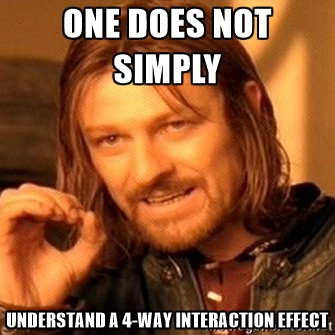 ]] --- ## A Non-Additive World 1. Replicating Categorical Variable Combinations: Factorial Models 2. Evaluating Interaction Effects 3. How to Look at Means and Differences with an Interaction Effect. 4. .red[ Continuous Variables and Interaction Effects ] --- ## Problem: What if Continuous Predictors are Not Additive? <div class="plotly html-widget html-fill-item" id="htmlwidget-f2359a266b9222744227" style="width:504px;height:432px;"></div> <script type="application/json" data-for="htmlwidget-f2359a266b9222744227">{"x":{"visdat":{"b4e92d4f15a":["function () ","plotlyVisDat"]},"cur_data":"b4e92d4f15a","attrs":{"b4e92d4f15a":{"x":{},"y":{},"z":{},"mode":"markers","color":{},"alpha_stroke":1,"sizes":[10,100],"spans":[1,20],"type":"scatter3d"}},"layout":{"margin":{"b":40,"l":60,"t":25,"r":10},"scene":{"xaxis":{"title":"age"},"yaxis":{"title":"elev"},"zaxis":{"title":"firesev"}},"hovermode":"closest","showlegend":false,"legend":{"yanchor":"top","y":0.5}},"source":"A","config":{"modeBarButtonsToAdd":["hoverclosest","hovercompare"],"showSendToCloud":false},"data":[{"x":[40,25,15,15,23,24,35,14,45,35,45,35,35,30,15,40,21,39,39,29,12,19,20,21,3,17,40,40,57,52,35,40,5,5,28,33,31,48,55,22,21,13,13,25,15,12,28,16,25,28,38,10,26,23,16,19,15,27,30,30,3,6,25,28,27,19,25,11,11,15,36,24,24,26,26,6,31,20,15,15,15,16,20,33,13,20,48,35,60,36],"y":[1225,60,200,200,970,970,950,740,170,190,210,185,185,210,400,400,200,90,95,640,700,110,120,160,75,100,210,235,160,180,750,880,90,80,490,470,475,425,450,120,120,410,500,215,390,390,240,215,600,275,400,665,650,645,660,650,675,670,680,600,275,300,590,550,550,480,480,475,475,450,450,350,365,260,250,210,170,130,475,475,980,350,335,300,650,750,730,700,870,575],"z":[3.5,4.0499999999999998,2.6000000000000001,2.8999999999999999,4.2999999999999998,4,4.7999999999999998,4.7999999999999998,7.25,6.2000000000000002,8.0500000000000007,7.5499999999999998,7.25,7.2999999999999998,3.7999999999999998,5.7000000000000002,4.2999999999999998,4.2000000000000002,4.25,5.0999999999999996,1.95,4.4000000000000004,4.4500000000000002,3,1.2,6.4000000000000004,8.1999999999999993,6.8499999999999996,6.1500000000000004,7.7000000000000002,6.0999999999999996,4.2999999999999998,3.75,3.7000000000000002,5.7000000000000002,5.4000000000000004,4.8499999999999996,4.8499999999999996,4.2999999999999998,3.25,2.5,3.8500000000000001,2.5499999999999998,3.2999999999999998,4,3.3999999999999999,3.8999999999999999,4,7.5,4.9000000000000004,4.7000000000000002,1.7,3,6,6.7000000000000002,2,6.0499999999999998,3.8999999999999999,2.8999999999999999,3.7000000000000002,1.2,1.3,3.6000000000000001,4.4000000000000004,3.7000000000000002,4.8499999999999996,4.8499999999999996,5.5999999999999996,4.0999999999999996,5.7000000000000002,4.2000000000000002,4.7999999999999998,7.2000000000000002,9.1999999999999993,6.2000000000000002,2.1000000000000001,3.8500000000000001,3.8999999999999999,4.8499999999999996,5.2999999999999998,4.5999999999999996,3.2999999999999998,5.4000000000000004,4.2999999999999998,3.6000000000000001,3,3.7999999999999998,4.5,3.8999999999999999,4.5999999999999996],"mode":"markers","type":"scatter3d","marker":{"colorbar":{"title":"firesev","ticklen":2},"cmin":1.2,"cmax":9.1999999999999993,"colorscale":[["0","rgba(68,1,84,1)"],["0.0416666666666667","rgba(70,19,97,1)"],["0.0833333333333334","rgba(72,32,111,1)"],["0.125","rgba(71,45,122,1)"],["0.166666666666667","rgba(68,58,128,1)"],["0.208333333333333","rgba(64,70,135,1)"],["0.25","rgba(60,82,138,1)"],["0.291666666666667","rgba(56,93,140,1)"],["0.333333333333333","rgba(49,104,142,1)"],["0.375","rgba(46,114,142,1)"],["0.416666666666667","rgba(42,123,142,1)"],["0.458333333333333","rgba(38,133,141,1)"],["0.5","rgba(37,144,140,1)"],["0.541666666666667","rgba(33,154,138,1)"],["0.583333333333333","rgba(39,164,133,1)"],["0.625","rgba(47,174,127,1)"],["0.666666666666667","rgba(53,183,121,1)"],["0.708333333333333","rgba(79,191,110,1)"],["0.75","rgba(98,199,98,1)"],["0.791666666666667","rgba(119,207,85,1)"],["0.833333333333333","rgba(147,214,70,1)"],["0.875","rgba(172,220,52,1)"],["0.916666666666667","rgba(199,225,42,1)"],["0.958333333333333","rgba(226,228,40,1)"],["1","rgba(253,231,37,1)"]],"showscale":false,"color":[3.5,4.0499999999999998,2.6000000000000001,2.8999999999999999,4.2999999999999998,4,4.7999999999999998,4.7999999999999998,7.25,6.2000000000000002,8.0500000000000007,7.5499999999999998,7.25,7.2999999999999998,3.7999999999999998,5.7000000000000002,4.2999999999999998,4.2000000000000002,4.25,5.0999999999999996,1.95,4.4000000000000004,4.4500000000000002,3,1.2,6.4000000000000004,8.1999999999999993,6.8499999999999996,6.1500000000000004,7.7000000000000002,6.0999999999999996,4.2999999999999998,3.75,3.7000000000000002,5.7000000000000002,5.4000000000000004,4.8499999999999996,4.8499999999999996,4.2999999999999998,3.25,2.5,3.8500000000000001,2.5499999999999998,3.2999999999999998,4,3.3999999999999999,3.8999999999999999,4,7.5,4.9000000000000004,4.7000000000000002,1.7,3,6,6.7000000000000002,2,6.0499999999999998,3.8999999999999999,2.8999999999999999,3.7000000000000002,1.2,1.3,3.6000000000000001,4.4000000000000004,3.7000000000000002,4.8499999999999996,4.8499999999999996,5.5999999999999996,4.0999999999999996,5.7000000000000002,4.2000000000000002,4.7999999999999998,7.2000000000000002,9.1999999999999993,6.2000000000000002,2.1000000000000001,3.8500000000000001,3.8999999999999999,4.8499999999999996,5.2999999999999998,4.5999999999999996,3.2999999999999998,5.4000000000000004,4.2999999999999998,3.6000000000000001,3,3.7999999999999998,4.5,3.8999999999999999,4.5999999999999996],"line":{"colorbar":{"title":"","ticklen":2},"cmin":1.2,"cmax":9.1999999999999993,"colorscale":[["0","rgba(68,1,84,1)"],["0.0416666666666667","rgba(70,19,97,1)"],["0.0833333333333334","rgba(72,32,111,1)"],["0.125","rgba(71,45,122,1)"],["0.166666666666667","rgba(68,58,128,1)"],["0.208333333333333","rgba(64,70,135,1)"],["0.25","rgba(60,82,138,1)"],["0.291666666666667","rgba(56,93,140,1)"],["0.333333333333333","rgba(49,104,142,1)"],["0.375","rgba(46,114,142,1)"],["0.416666666666667","rgba(42,123,142,1)"],["0.458333333333333","rgba(38,133,141,1)"],["0.5","rgba(37,144,140,1)"],["0.541666666666667","rgba(33,154,138,1)"],["0.583333333333333","rgba(39,164,133,1)"],["0.625","rgba(47,174,127,1)"],["0.666666666666667","rgba(53,183,121,1)"],["0.708333333333333","rgba(79,191,110,1)"],["0.75","rgba(98,199,98,1)"],["0.791666666666667","rgba(119,207,85,1)"],["0.833333333333333","rgba(147,214,70,1)"],["0.875","rgba(172,220,52,1)"],["0.916666666666667","rgba(199,225,42,1)"],["0.958333333333333","rgba(226,228,40,1)"],["1","rgba(253,231,37,1)"]],"showscale":false,"color":[3.5,4.0499999999999998,2.6000000000000001,2.8999999999999999,4.2999999999999998,4,4.7999999999999998,4.7999999999999998,7.25,6.2000000000000002,8.0500000000000007,7.5499999999999998,7.25,7.2999999999999998,3.7999999999999998,5.7000000000000002,4.2999999999999998,4.2000000000000002,4.25,5.0999999999999996,1.95,4.4000000000000004,4.4500000000000002,3,1.2,6.4000000000000004,8.1999999999999993,6.8499999999999996,6.1500000000000004,7.7000000000000002,6.0999999999999996,4.2999999999999998,3.75,3.7000000000000002,5.7000000000000002,5.4000000000000004,4.8499999999999996,4.8499999999999996,4.2999999999999998,3.25,2.5,3.8500000000000001,2.5499999999999998,3.2999999999999998,4,3.3999999999999999,3.8999999999999999,4,7.5,4.9000000000000004,4.7000000000000002,1.7,3,6,6.7000000000000002,2,6.0499999999999998,3.8999999999999999,2.8999999999999999,3.7000000000000002,1.2,1.3,3.6000000000000001,4.4000000000000004,3.7000000000000002,4.8499999999999996,4.8499999999999996,5.5999999999999996,4.0999999999999996,5.7000000000000002,4.2000000000000002,4.7999999999999998,7.2000000000000002,9.1999999999999993,6.2000000000000002,2.1000000000000001,3.8500000000000001,3.8999999999999999,4.8499999999999996,5.2999999999999998,4.5999999999999996,3.2999999999999998,5.4000000000000004,4.2999999999999998,3.6000000000000001,3,3.7999999999999998,4.5,3.8999999999999999,4.5999999999999996]}},"frame":null},{"x":[3,60],"y":[60,1225],"type":"scatter3d","mode":"markers","opacity":0,"hoverinfo":"none","showlegend":false,"marker":{"colorbar":{"title":"firesev","ticklen":2,"len":0.5,"lenmode":"fraction","y":1,"yanchor":"top"},"cmin":1.2,"cmax":9.1999999999999993,"colorscale":[["0","rgba(68,1,84,1)"],["0.0416666666666667","rgba(70,19,97,1)"],["0.0833333333333334","rgba(72,32,111,1)"],["0.125","rgba(71,45,122,1)"],["0.166666666666667","rgba(68,58,128,1)"],["0.208333333333333","rgba(64,70,135,1)"],["0.25","rgba(60,82,138,1)"],["0.291666666666667","rgba(56,93,140,1)"],["0.333333333333333","rgba(49,104,142,1)"],["0.375","rgba(46,114,142,1)"],["0.416666666666667","rgba(42,123,142,1)"],["0.458333333333333","rgba(38,133,141,1)"],["0.5","rgba(37,144,140,1)"],["0.541666666666667","rgba(33,154,138,1)"],["0.583333333333333","rgba(39,164,133,1)"],["0.625","rgba(47,174,127,1)"],["0.666666666666667","rgba(53,183,121,1)"],["0.708333333333333","rgba(79,191,110,1)"],["0.75","rgba(98,199,98,1)"],["0.791666666666667","rgba(119,207,85,1)"],["0.833333333333333","rgba(147,214,70,1)"],["0.875","rgba(172,220,52,1)"],["0.916666666666667","rgba(199,225,42,1)"],["0.958333333333333","rgba(226,228,40,1)"],["1","rgba(253,231,37,1)"]],"showscale":true,"color":[1.2,9.1999999999999993],"line":{"color":"rgba(255,127,14,1)"}},"z":[1.2,9.1999999999999993],"frame":null}],"highlight":{"on":"plotly_click","persistent":false,"dynamic":false,"selectize":false,"opacityDim":0.20000000000000001,"selected":{"opacity":1},"debounce":0},"shinyEvents":["plotly_hover","plotly_click","plotly_selected","plotly_relayout","plotly_brushed","plotly_brushing","plotly_clickannotation","plotly_doubleclick","plotly_deselect","plotly_afterplot","plotly_sunburstclick"],"base_url":"https://plot.ly"},"evals":[],"jsHooks":[]}</script> ## Problem: What if Continuous Predictors are Not Additive? <img src="interactions_lm_files/figure-html/keeley_int_plot-1.png" style="display: block; margin: auto;" /> ## Problem: What if Continuous Predictors are Not Additive? <img src="interactions_lm_files/figure-html/keeley_int_plot2-1.png" style="display: block; margin: auto;" /> --- class:center, middle 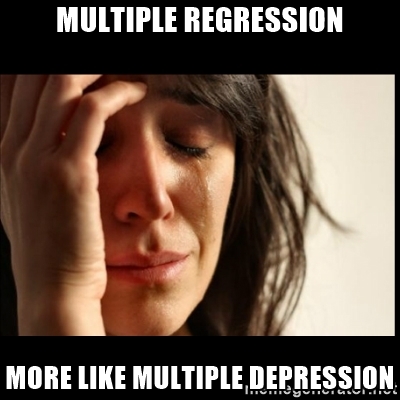 --- ## Model For Age Interacting with Elevation to Influence Fire Severity `$$y_i = \beta_0 + \beta_{1}x_{1i} + \beta_{2}x_{2i}+ \beta_{3}x_{1i}x_{2i} + \epsilon_{i}$$` `$$\epsilon_{i} \sim \mathcal{N}(0,\sigma^2)$$` Or in code: ``` r keeley_lm_int <- lm(firesev ~ age * elev, data=keeley) ``` --- ## Assumption Tests as Usual! <img src="interactions_lm_files/figure-html/klm_diag_int-1.png" style="display: block; margin: auto;" /> --- ## Examine Residuals With Respect to Each Predictor <img src="interactions_lm_files/figure-html/klm_diag2_int-1.png" style="display: block; margin: auto;" /> --- ## Interactions, VIF, and Centering ``` # Check for Multicollinearity Low Correlation Term VIF VIF 95% CI Increased SE Tolerance Tolerance 95% CI age 3.20 [2.37, 4.52] 1.79 0.31 [0.22, 0.42] Moderate Correlation Term VIF VIF 95% CI Increased SE Tolerance Tolerance 95% CI elev 5.52 [3.95, 7.92] 2.35 0.18 [0.13, 0.25] age:elev 8.29 [5.83, 11.98] 2.88 0.12 [0.08, 0.17] ``` - Collinearities between additive predictors and interaction effects are not problematic. -- - However, you should make sure your ADDITIVE predictors do not have VIF problems in a model with no interactions. -- - If you are worried, **center** your predictors - i.e., `\(X_i - mean(X)\)` - This can fix issues with models not converging --- ## Interpretation of Centered Coefficients `$$\huge X_i - \bar{X}$$` -- - Additive coefficients are the effect of a predictor at the mean value of the other predictors -- - Intercepts are at the mean value of all predictors -- - Visualization will keep you from getting confused! --- ## Interactions, VIF, and Centering `$$y = \beta_0 + \beta_{1}(x_{1}-\bar{x_{1}}) + \beta_{2}(x_{2}-\bar{x_{2}})+ \beta_{3}(x_{1}-\bar{x_{1}})(x_{2}-\bar{x_{2}})$$` Variance Inflation Factors for Centered Model: ``` # Check for Multicollinearity Low Correlation Term VIF VIF 95% CI Increased SE Tolerance Tolerance 95% CI age_c 1.02 [1.00, 2376.13] 1.01 0.98 [0.00, 1.00] elev_c 1.04 [1.00, 7.04] 1.02 0.96 [0.14, 1.00] age_c:elev_c 1.04 [1.00, 9.78] 1.02 0.96 [0.10, 1.00] ``` --- ## Coefficients! <table class="table table-striped" style="color: black; margin-left: auto; margin-right: auto;"> <thead> <tr> <th style="text-align:left;"> term </th> <th style="text-align:right;"> estimate </th> <th style="text-align:right;"> std.error </th> <th style="text-align:right;"> statistic </th> <th style="text-align:right;"> p.value </th> </tr> </thead> <tbody> <tr> <td style="text-align:left;"> (Intercept) </td> <td style="text-align:right;"> 1.8132153 </td> <td style="text-align:right;"> 0.6156070 </td> <td style="text-align:right;"> 2.945411 </td> <td style="text-align:right;"> 0.0041484 </td> </tr> <tr> <td style="text-align:left;"> age </td> <td style="text-align:right;"> 0.1206292 </td> <td style="text-align:right;"> 0.0208618 </td> <td style="text-align:right;"> 5.782298 </td> <td style="text-align:right;"> 0.0000001 </td> </tr> <tr> <td style="text-align:left;"> elev </td> <td style="text-align:right;"> 0.0030852 </td> <td style="text-align:right;"> 0.0013329 </td> <td style="text-align:right;"> 2.314588 </td> <td style="text-align:right;"> 0.0230186 </td> </tr> <tr> <td style="text-align:left;"> age:elev </td> <td style="text-align:right;"> -0.0001472 </td> <td style="text-align:right;"> 0.0000431 </td> <td style="text-align:right;"> -3.416029 </td> <td style="text-align:right;"> 0.0009722 </td> </tr> </tbody> </table> R<sup>2</sup> = 0.3235187. Note that additive coefficients signify the effect of one predictor in the abscence of all others. --- ## Centered Coefficients! <table class="table table-striped" style="color: black; margin-left: auto; margin-right: auto;"> <thead> <tr> <th style="text-align:left;"> term </th> <th style="text-align:right;"> estimate </th> <th style="text-align:right;"> std.error </th> <th style="text-align:right;"> statistic </th> <th style="text-align:right;"> p.value </th> </tr> </thead> <tbody> <tr> <td style="text-align:left;"> (Intercept) </td> <td style="text-align:right;"> 4.6091266 </td> <td style="text-align:right;"> 0.1463029 </td> <td style="text-align:right;"> 31.503991 </td> <td style="text-align:right;"> 0.0000000 </td> </tr> <tr> <td style="text-align:left;"> age_c </td> <td style="text-align:right;"> 0.0581123 </td> <td style="text-align:right;"> 0.0117591 </td> <td style="text-align:right;"> 4.941901 </td> <td style="text-align:right;"> 0.0000038 </td> </tr> <tr> <td style="text-align:left;"> elev_c </td> <td style="text-align:right;"> -0.0006786 </td> <td style="text-align:right;"> 0.0005792 </td> <td style="text-align:right;"> -1.171587 </td> <td style="text-align:right;"> 0.2445985 </td> </tr> <tr> <td style="text-align:left;"> age_c:elev_c </td> <td style="text-align:right;"> -0.0001472 </td> <td style="text-align:right;"> 0.0000431 </td> <td style="text-align:right;"> -3.416029 </td> <td style="text-align:right;"> 0.0009722 </td> </tr> </tbody> </table> R<sup>2</sup> = 0.3235187 Note that additive coefficients signify the effect of one predictor at the average level of all others. --- ## Interpretation - What the heck does a continuous interaction effect mean? -- - We can look at the effect of one variable at different levels of the other -- - We can look at a surface -- - We can construct *counterfactual* plots showing how changing both variables influences our outcome --- ## Age at Different Levels of Elevation <img src="interactions_lm_files/figure-html/int_visreg-1.png" style="display: block; margin: auto;" /> --- ## Elevation at Different Levels of Age <img src="interactions_lm_files/figure-html/int_visreg_2-1.png" style="display: block; margin: auto;" /> --- ## Or all in one plot <img src="interactions_lm_files/figure-html/keeley_int_pred-1.png" style="display: block; margin: auto;" /> --- ## Without Data and Including CIs <img src="interactions_lm_files/figure-html/keeley_int_pred_nodata-1.png" style="display: block; margin: auto;" /> --- ## A Heatmap Approach <img src="interactions_lm_files/figure-html/int_heatmap-1.png" style="display: block; margin: auto;" /> --- ## Surfaces and Other 3d Objects <div class="plotly html-widget html-fill-item" id="htmlwidget-b8e027c1ae3e3aa81321" style="width:720px;height:576px;"></div> <script type="application/json" data-for="htmlwidget-b8e027c1ae3e3aa81321">{"x":{"visdat":{"b4e9560975a5":["function () ","plotlyVisDat"],"b4e970acfc4":["function () ","data"]},"cur_data":"b4e970acfc4","attrs":{"b4e9560975a5":{"x":{},"y":{},"z":{},"mode":"surface","color":{},"alpha_stroke":1,"sizes":[10,100],"spans":[1,20],"type":"scatter3d"},"b4e970acfc4":{"x":{},"y":{},"z":{},"mode":"markers","color":["black"],"alpha_stroke":1,"sizes":[10,100],"spans":[1,20],"type":"scatter3d","inherit":true}},"layout":{"margin":{"b":40,"l":60,"t":25,"r":10},"scene":{"xaxis":{"title":"age"},"yaxis":{"title":"elev"},"zaxis":{"title":"firesev"}},"hovermode":"closest","showlegend":true,"legend":{"yanchor":"top","y":0.5}},"source":"A","config":{"modeBarButtonsToAdd":["hoverclosest","hovercompare"],"showSendToCloud":false},"data":[{"x":[0,0,0,0,0,0,0,0,0,0,0,0,0,0,0,0,0,0,0,0,0,0,0,0,0,0,0,0,0,0,0,0,0,0,0,0,0,0,0,0,0,0,0,0,0,0,0,0,0,0,0,0,0,0,0,0,0,0,0,0,0,0,0,0,0,0,0,0,0,0,0,0,0,0,0,0,0,0,0,0,0,0,0,0,0,0,0,0,0,0,0,0,0,0,0,0,0,0,0,0,0,0,0,0,0,0,0,0,0,0,0,0,0,0,0,0,0,0,0,0,0,0,0,0,0,0,0,0,0,0,0,0,0,0,0,0,0,0,0,0,0,0,0,0,0,0,0,0,0,0,0,0,0,0,0,0,0,0,0,0,0,0,0,0,0,0,0,0,0,0,0,0,0,0,0,0,0,0,0,0,0,0,0,0,0,0,0,0,0,0,0,0,0,0,0,0,0,0,0,0,0.30150753768844218,0.30150753768844218,0.30150753768844218,0.30150753768844218,0.30150753768844218,0.30150753768844218,0.30150753768844218,0.30150753768844218,0.30150753768844218,0.30150753768844218,0.30150753768844218,0.30150753768844218,0.30150753768844218,0.30150753768844218,0.30150753768844218,0.30150753768844218,0.30150753768844218,0.30150753768844218,0.30150753768844218,0.30150753768844218,0.30150753768844218,0.30150753768844218,0.30150753768844218,0.30150753768844218,0.30150753768844218,0.30150753768844218,0.30150753768844218,0.30150753768844218,0.30150753768844218,0.30150753768844218,0.30150753768844218,0.30150753768844218,0.30150753768844218,0.30150753768844218,0.30150753768844218,0.30150753768844218,0.30150753768844218,0.30150753768844218,0.30150753768844218,0.30150753768844218,0.30150753768844218,0.30150753768844218,0.30150753768844218,0.30150753768844218,0.30150753768844218,0.30150753768844218,0.30150753768844218,0.30150753768844218,0.30150753768844218,0.30150753768844218,0.30150753768844218,0.30150753768844218,0.30150753768844218,0.30150753768844218,0.30150753768844218,0.30150753768844218,0.30150753768844218,0.30150753768844218,0.30150753768844218,0.30150753768844218,0.30150753768844218,0.30150753768844218,0.30150753768844218,0.30150753768844218,0.30150753768844218,0.30150753768844218,0.30150753768844218,0.30150753768844218,0.30150753768844218,0.30150753768844218,0.30150753768844218,0.30150753768844218,0.30150753768844218,0.30150753768844218,0.30150753768844218,0.30150753768844218,0.30150753768844218,0.30150753768844218,0.30150753768844218,0.30150753768844218,0.30150753768844218,0.30150753768844218,0.30150753768844218,0.30150753768844218,0.30150753768844218,0.30150753768844218,0.30150753768844218,0.30150753768844218,0.30150753768844218,0.30150753768844218,0.30150753768844218,0.30150753768844218,0.30150753768844218,0.30150753768844218,0.30150753768844218,0.30150753768844218,0.30150753768844218,0.30150753768844218,0.30150753768844218,0.30150753768844218,0.30150753768844218,0.30150753768844218,0.30150753768844218,0.30150753768844218,0.30150753768844218,0.30150753768844218,0.30150753768844218,0.30150753768844218,0.30150753768844218,0.30150753768844218,0.30150753768844218,0.30150753768844218,0.30150753768844218,0.30150753768844218,0.30150753768844218,0.30150753768844218,0.30150753768844218,0.30150753768844218,0.30150753768844218,0.30150753768844218,0.30150753768844218,0.30150753768844218,0.30150753768844218,0.30150753768844218,0.30150753768844218,0.30150753768844218,0.30150753768844218,0.30150753768844218,0.30150753768844218,0.30150753768844218,0.30150753768844218,0.30150753768844218,0.30150753768844218,0.30150753768844218,0.30150753768844218,0.30150753768844218,0.30150753768844218,0.30150753768844218,0.30150753768844218,0.30150753768844218,0.30150753768844218,0.30150753768844218,0.30150753768844218,0.30150753768844218,0.30150753768844218,0.30150753768844218,0.30150753768844218,0.30150753768844218,0.30150753768844218,0.30150753768844218,0.30150753768844218,0.30150753768844218,0.30150753768844218,0.30150753768844218,0.30150753768844218,0.30150753768844218,0.30150753768844218,0.30150753768844218,0.30150753768844218,0.30150753768844218,0.30150753768844218,0.30150753768844218,0.30150753768844218,0.30150753768844218,0.30150753768844218,0.30150753768844218,0.30150753768844218,0.30150753768844218,0.30150753768844218,0.30150753768844218,0.30150753768844218,0.30150753768844218,0.30150753768844218,0.30150753768844218,0.30150753768844218,0.30150753768844218,0.30150753768844218,0.30150753768844218,0.30150753768844218,0.30150753768844218,0.30150753768844218,0.30150753768844218,0.30150753768844218,0.30150753768844218,0.30150753768844218,0.30150753768844218,0.30150753768844218,0.30150753768844218,0.30150753768844218,0.30150753768844218,0.30150753768844218,0.30150753768844218,0.30150753768844218,0.30150753768844218,0.30150753768844218,0.30150753768844218,0.30150753768844218,0.30150753768844218,0.30150753768844218,0.30150753768844218,0.60301507537688437,0.60301507537688437,0.60301507537688437,0.60301507537688437,0.60301507537688437,0.60301507537688437,0.60301507537688437,0.60301507537688437,0.60301507537688437,0.60301507537688437,0.60301507537688437,0.60301507537688437,0.60301507537688437,0.60301507537688437,0.60301507537688437,0.60301507537688437,0.60301507537688437,0.60301507537688437,0.60301507537688437,0.60301507537688437,0.60301507537688437,0.60301507537688437,0.60301507537688437,0.60301507537688437,0.60301507537688437,0.60301507537688437,0.60301507537688437,0.60301507537688437,0.60301507537688437,0.60301507537688437,0.60301507537688437,0.60301507537688437,0.60301507537688437,0.60301507537688437,0.60301507537688437,0.60301507537688437,0.60301507537688437,0.60301507537688437,0.60301507537688437,0.60301507537688437,0.60301507537688437,0.60301507537688437,0.60301507537688437,0.60301507537688437,0.60301507537688437,0.60301507537688437,0.60301507537688437,0.60301507537688437,0.60301507537688437,0.60301507537688437,0.60301507537688437,0.60301507537688437,0.60301507537688437,0.60301507537688437,0.60301507537688437,0.60301507537688437,0.60301507537688437,0.60301507537688437,0.60301507537688437,0.60301507537688437,0.60301507537688437,0.60301507537688437,0.60301507537688437,0.60301507537688437,0.60301507537688437,0.60301507537688437,0.60301507537688437,0.60301507537688437,0.60301507537688437,0.60301507537688437,0.60301507537688437,0.60301507537688437,0.60301507537688437,0.60301507537688437,0.60301507537688437,0.60301507537688437,0.60301507537688437,0.60301507537688437,0.60301507537688437,0.60301507537688437,0.60301507537688437,0.60301507537688437,0.60301507537688437,0.60301507537688437,0.60301507537688437,0.60301507537688437,0.60301507537688437,0.60301507537688437,0.60301507537688437,0.60301507537688437,0.60301507537688437,0.60301507537688437,0.60301507537688437,0.60301507537688437,0.60301507537688437,0.60301507537688437,0.60301507537688437,0.60301507537688437,0.60301507537688437,0.60301507537688437,0.60301507537688437,0.60301507537688437,0.60301507537688437,0.60301507537688437,0.60301507537688437,0.60301507537688437,0.60301507537688437,0.60301507537688437,0.60301507537688437,0.60301507537688437,0.60301507537688437,0.60301507537688437,0.60301507537688437,0.60301507537688437,0.60301507537688437,0.60301507537688437,0.60301507537688437,0.60301507537688437,0.60301507537688437,0.60301507537688437,0.60301507537688437,0.60301507537688437,0.60301507537688437,0.60301507537688437,0.60301507537688437,0.60301507537688437,0.60301507537688437,0.60301507537688437,0.60301507537688437,0.60301507537688437,0.60301507537688437,0.60301507537688437,0.60301507537688437,0.60301507537688437,0.60301507537688437,0.60301507537688437,0.60301507537688437,0.60301507537688437,0.60301507537688437,0.60301507537688437,0.60301507537688437,0.60301507537688437,0.60301507537688437,0.60301507537688437,0.60301507537688437,0.60301507537688437,0.60301507537688437,0.60301507537688437,0.60301507537688437,0.60301507537688437,0.60301507537688437,0.60301507537688437,0.60301507537688437,0.60301507537688437,0.60301507537688437,0.60301507537688437,0.60301507537688437,0.60301507537688437,0.60301507537688437,0.60301507537688437,0.60301507537688437,0.60301507537688437,0.60301507537688437,0.60301507537688437,0.60301507537688437,0.60301507537688437,0.60301507537688437,0.60301507537688437,0.60301507537688437,0.60301507537688437,0.60301507537688437,0.60301507537688437,0.60301507537688437,0.60301507537688437,0.60301507537688437,0.60301507537688437,0.60301507537688437,0.60301507537688437,0.60301507537688437,0.60301507537688437,0.60301507537688437,0.60301507537688437,0.60301507537688437,0.60301507537688437,0.60301507537688437,0.60301507537688437,0.60301507537688437,0.60301507537688437,0.60301507537688437,0.60301507537688437,0.60301507537688437,0.60301507537688437,0.60301507537688437,0.60301507537688437,0.60301507537688437,0.60301507537688437,0.60301507537688437,0.60301507537688437,0.60301507537688437,0.60301507537688437,0.90452261306532655,0.90452261306532655,0.90452261306532655,0.90452261306532655,0.90452261306532655,0.90452261306532655,0.90452261306532655,0.90452261306532655,0.90452261306532655,0.90452261306532655,0.90452261306532655,0.90452261306532655,0.90452261306532655,0.90452261306532655,0.90452261306532655,0.90452261306532655,0.90452261306532655,0.90452261306532655,0.90452261306532655,0.90452261306532655,0.90452261306532655,0.90452261306532655,0.90452261306532655,0.90452261306532655,0.90452261306532655,0.90452261306532655,0.90452261306532655,0.90452261306532655,0.90452261306532655,0.90452261306532655,0.90452261306532655,0.90452261306532655,0.90452261306532655,0.90452261306532655,0.90452261306532655,0.90452261306532655,0.90452261306532655,0.90452261306532655,0.90452261306532655,0.90452261306532655,0.90452261306532655,0.90452261306532655,0.90452261306532655,0.90452261306532655,0.90452261306532655,0.90452261306532655,0.90452261306532655,0.90452261306532655,0.90452261306532655,0.90452261306532655,0.90452261306532655,0.90452261306532655,0.90452261306532655,0.90452261306532655,0.90452261306532655,0.90452261306532655,0.90452261306532655,0.90452261306532655,0.90452261306532655,0.90452261306532655,0.90452261306532655,0.90452261306532655,0.90452261306532655,0.90452261306532655,0.90452261306532655,0.90452261306532655,0.90452261306532655,0.90452261306532655,0.90452261306532655,0.90452261306532655,0.90452261306532655,0.90452261306532655,0.90452261306532655,0.90452261306532655,0.90452261306532655,0.90452261306532655,0.90452261306532655,0.90452261306532655,0.90452261306532655,0.90452261306532655,0.90452261306532655,0.90452261306532655,0.90452261306532655,0.90452261306532655,0.90452261306532655,0.90452261306532655,0.90452261306532655,0.90452261306532655,0.90452261306532655,0.90452261306532655,0.90452261306532655,0.90452261306532655,0.90452261306532655,0.90452261306532655,0.90452261306532655,0.90452261306532655,0.90452261306532655,0.90452261306532655,0.90452261306532655,0.90452261306532655,0.90452261306532655,0.90452261306532655,0.90452261306532655,0.90452261306532655,0.90452261306532655,0.90452261306532655,0.90452261306532655,0.90452261306532655,0.90452261306532655,0.90452261306532655,0.90452261306532655,0.90452261306532655,0.90452261306532655,0.90452261306532655,0.90452261306532655,0.90452261306532655,0.90452261306532655,0.90452261306532655,0.90452261306532655,0.90452261306532655,0.90452261306532655,0.90452261306532655,0.90452261306532655,0.90452261306532655,0.90452261306532655,0.90452261306532655,0.90452261306532655,0.90452261306532655,0.90452261306532655,0.90452261306532655,0.90452261306532655,0.90452261306532655,0.90452261306532655,0.90452261306532655,0.90452261306532655,0.90452261306532655,0.90452261306532655,0.90452261306532655,0.90452261306532655,0.90452261306532655,0.90452261306532655,0.90452261306532655,0.90452261306532655,0.90452261306532655,0.90452261306532655,0.90452261306532655,0.90452261306532655,0.90452261306532655,0.90452261306532655,0.90452261306532655,0.90452261306532655,0.90452261306532655,0.90452261306532655,0.90452261306532655,0.90452261306532655,0.90452261306532655,0.90452261306532655,0.90452261306532655,0.90452261306532655,0.90452261306532655,0.90452261306532655,0.90452261306532655,0.90452261306532655,0.90452261306532655,0.90452261306532655,0.90452261306532655,0.90452261306532655,0.90452261306532655,0.90452261306532655,0.90452261306532655,0.90452261306532655,0.90452261306532655,0.90452261306532655,0.90452261306532655,0.90452261306532655,0.90452261306532655,0.90452261306532655,0.90452261306532655,0.90452261306532655,0.90452261306532655,0.90452261306532655,0.90452261306532655,0.90452261306532655,0.90452261306532655,0.90452261306532655,0.90452261306532655,0.90452261306532655,0.90452261306532655,0.90452261306532655,0.90452261306532655,0.90452261306532655,0.90452261306532655,0.90452261306532655,0.90452261306532655,0.90452261306532655,0.90452261306532655,0.90452261306532655,0.90452261306532655,0.90452261306532655,0.90452261306532655,1.2060301507537687,1.2060301507537687,1.2060301507537687,1.2060301507537687,1.2060301507537687,1.2060301507537687,1.2060301507537687,1.2060301507537687,1.2060301507537687,1.2060301507537687,1.2060301507537687,1.2060301507537687,1.2060301507537687,1.2060301507537687,1.2060301507537687,1.2060301507537687,1.2060301507537687,1.2060301507537687,1.2060301507537687,1.2060301507537687,1.2060301507537687,1.2060301507537687,1.2060301507537687,1.2060301507537687,1.2060301507537687,1.2060301507537687,1.2060301507537687,1.2060301507537687,1.2060301507537687,1.2060301507537687,1.2060301507537687,1.2060301507537687,1.2060301507537687,1.2060301507537687,1.2060301507537687,1.2060301507537687,1.2060301507537687,1.2060301507537687,1.2060301507537687,1.2060301507537687,1.2060301507537687,1.2060301507537687,1.2060301507537687,1.2060301507537687,1.2060301507537687,1.2060301507537687,1.2060301507537687,1.2060301507537687,1.2060301507537687,1.2060301507537687,1.2060301507537687,1.2060301507537687,1.2060301507537687,1.2060301507537687,1.2060301507537687,1.2060301507537687,1.2060301507537687,1.2060301507537687,1.2060301507537687,1.2060301507537687,1.2060301507537687,1.2060301507537687,1.2060301507537687,1.2060301507537687,1.2060301507537687,1.2060301507537687,1.2060301507537687,1.2060301507537687,1.2060301507537687,1.2060301507537687,1.2060301507537687,1.2060301507537687,1.2060301507537687,1.2060301507537687,1.2060301507537687,1.2060301507537687,1.2060301507537687,1.2060301507537687,1.2060301507537687,1.2060301507537687,1.2060301507537687,1.2060301507537687,1.2060301507537687,1.2060301507537687,1.2060301507537687,1.2060301507537687,1.2060301507537687,1.2060301507537687,1.2060301507537687,1.2060301507537687,1.2060301507537687,1.2060301507537687,1.2060301507537687,1.2060301507537687,1.2060301507537687,1.2060301507537687,1.2060301507537687,1.2060301507537687,1.2060301507537687,1.2060301507537687,1.2060301507537687,1.2060301507537687,1.2060301507537687,1.2060301507537687,1.2060301507537687,1.2060301507537687,1.2060301507537687,1.2060301507537687,1.2060301507537687,1.2060301507537687,1.2060301507537687,1.2060301507537687,1.2060301507537687,1.2060301507537687,1.2060301507537687,1.2060301507537687,1.2060301507537687,1.2060301507537687,1.2060301507537687,1.2060301507537687,1.2060301507537687,1.2060301507537687,1.2060301507537687,1.2060301507537687,1.2060301507537687,1.2060301507537687,1.2060301507537687,1.2060301507537687,1.2060301507537687,1.2060301507537687,1.2060301507537687,1.2060301507537687,1.2060301507537687,1.2060301507537687,1.2060301507537687,1.2060301507537687,1.2060301507537687,1.2060301507537687,1.2060301507537687,1.2060301507537687,1.2060301507537687,1.2060301507537687,1.2060301507537687,1.2060301507537687,1.2060301507537687,1.2060301507537687,1.2060301507537687,1.2060301507537687,1.2060301507537687,1.2060301507537687,1.2060301507537687,1.2060301507537687,1.2060301507537687,1.2060301507537687,1.2060301507537687,1.2060301507537687,1.2060301507537687,1.2060301507537687,1.2060301507537687,1.2060301507537687,1.2060301507537687,1.2060301507537687,1.2060301507537687,1.2060301507537687,1.2060301507537687,1.2060301507537687,1.2060301507537687,1.2060301507537687,1.2060301507537687,1.2060301507537687,1.2060301507537687,1.2060301507537687,1.2060301507537687,1.2060301507537687,1.2060301507537687,1.2060301507537687,1.2060301507537687,1.2060301507537687,1.2060301507537687,1.2060301507537687,1.2060301507537687,1.2060301507537687,1.2060301507537687,1.2060301507537687,1.2060301507537687,1.2060301507537687,1.2060301507537687,1.2060301507537687,1.2060301507537687,1.2060301507537687,1.2060301507537687,1.2060301507537687,1.2060301507537687,1.2060301507537687,1.2060301507537687,1.2060301507537687,1.2060301507537687,1.2060301507537687,1.2060301507537687,1.2060301507537687,1.5075376884422109,1.5075376884422109,1.5075376884422109,1.5075376884422109,1.5075376884422109,1.5075376884422109,1.5075376884422109,1.5075376884422109,1.5075376884422109,1.5075376884422109,1.5075376884422109,1.5075376884422109,1.5075376884422109,1.5075376884422109,1.5075376884422109,1.5075376884422109,1.5075376884422109,1.5075376884422109,1.5075376884422109,1.5075376884422109,1.5075376884422109,1.5075376884422109,1.5075376884422109,1.5075376884422109,1.5075376884422109,1.5075376884422109,1.5075376884422109,1.5075376884422109,1.5075376884422109,1.5075376884422109,1.5075376884422109,1.5075376884422109,1.5075376884422109,1.5075376884422109,1.5075376884422109,1.5075376884422109,1.5075376884422109,1.5075376884422109,1.5075376884422109,1.5075376884422109,1.5075376884422109,1.5075376884422109,1.5075376884422109,1.5075376884422109,1.5075376884422109,1.5075376884422109,1.5075376884422109,1.5075376884422109,1.5075376884422109,1.5075376884422109,1.5075376884422109,1.5075376884422109,1.5075376884422109,1.5075376884422109,1.5075376884422109,1.5075376884422109,1.5075376884422109,1.5075376884422109,1.5075376884422109,1.5075376884422109,1.5075376884422109,1.5075376884422109,1.5075376884422109,1.5075376884422109,1.5075376884422109,1.5075376884422109,1.5075376884422109,1.5075376884422109,1.5075376884422109,1.5075376884422109,1.5075376884422109,1.5075376884422109,1.5075376884422109,1.5075376884422109,1.5075376884422109,1.5075376884422109,1.5075376884422109,1.5075376884422109,1.5075376884422109,1.5075376884422109,1.5075376884422109,1.5075376884422109,1.5075376884422109,1.5075376884422109,1.5075376884422109,1.5075376884422109,1.5075376884422109,1.5075376884422109,1.5075376884422109,1.5075376884422109,1.5075376884422109,1.5075376884422109,1.5075376884422109,1.5075376884422109,1.5075376884422109,1.5075376884422109,1.5075376884422109,1.5075376884422109,1.5075376884422109,1.5075376884422109,1.5075376884422109,1.5075376884422109,1.5075376884422109,1.5075376884422109,1.5075376884422109,1.5075376884422109,1.5075376884422109,1.5075376884422109,1.5075376884422109,1.5075376884422109,1.5075376884422109,1.5075376884422109,1.5075376884422109,1.5075376884422109,1.5075376884422109,1.5075376884422109,1.5075376884422109,1.5075376884422109,1.5075376884422109,1.5075376884422109,1.5075376884422109,1.5075376884422109,1.5075376884422109,1.5075376884422109,1.5075376884422109,1.5075376884422109,1.5075376884422109,1.5075376884422109,1.5075376884422109,1.5075376884422109,1.5075376884422109,1.5075376884422109,1.5075376884422109,1.5075376884422109,1.5075376884422109,1.5075376884422109,1.5075376884422109,1.5075376884422109,1.5075376884422109,1.5075376884422109,1.5075376884422109,1.5075376884422109,1.5075376884422109,1.5075376884422109,1.5075376884422109,1.5075376884422109,1.5075376884422109,1.5075376884422109,1.5075376884422109,1.5075376884422109,1.5075376884422109,1.5075376884422109,1.5075376884422109,1.5075376884422109,1.5075376884422109,1.5075376884422109,1.5075376884422109,1.5075376884422109,1.5075376884422109,1.5075376884422109,1.5075376884422109,1.5075376884422109,1.5075376884422109,1.5075376884422109,1.5075376884422109,1.5075376884422109,1.5075376884422109,1.5075376884422109,1.5075376884422109,1.5075376884422109,1.5075376884422109,1.5075376884422109,1.5075376884422109,1.5075376884422109,1.5075376884422109,1.5075376884422109,1.5075376884422109,1.5075376884422109,1.5075376884422109,1.5075376884422109,1.5075376884422109,1.5075376884422109,1.5075376884422109,1.5075376884422109,1.5075376884422109,1.5075376884422109,1.5075376884422109,1.5075376884422109,1.5075376884422109,1.5075376884422109,1.5075376884422109,1.5075376884422109,1.5075376884422109,1.5075376884422109,1.5075376884422109,1.5075376884422109,1.5075376884422109,1.5075376884422109,1.5075376884422109,1.5075376884422109,1.8090452261306531,1.8090452261306531,1.8090452261306531,1.8090452261306531,1.8090452261306531,1.8090452261306531,1.8090452261306531,1.8090452261306531,1.8090452261306531,1.8090452261306531,1.8090452261306531,1.8090452261306531,1.8090452261306531,1.8090452261306531,1.8090452261306531,1.8090452261306531,1.8090452261306531,1.8090452261306531,1.8090452261306531,1.8090452261306531,1.8090452261306531,1.8090452261306531,1.8090452261306531,1.8090452261306531,1.8090452261306531,1.8090452261306531,1.8090452261306531,1.8090452261306531,1.8090452261306531,1.8090452261306531,1.8090452261306531,1.8090452261306531,1.8090452261306531,1.8090452261306531,1.8090452261306531,1.8090452261306531,1.8090452261306531,1.8090452261306531,1.8090452261306531,1.8090452261306531,1.8090452261306531,1.8090452261306531,1.8090452261306531,1.8090452261306531,1.8090452261306531,1.8090452261306531,1.8090452261306531,1.8090452261306531,1.8090452261306531,1.8090452261306531,1.8090452261306531,1.8090452261306531,1.8090452261306531,1.8090452261306531,1.8090452261306531,1.8090452261306531,1.8090452261306531,1.8090452261306531,1.8090452261306531,1.8090452261306531,1.8090452261306531,1.8090452261306531,1.8090452261306531,1.8090452261306531,1.8090452261306531,1.8090452261306531,1.8090452261306531,1.8090452261306531,1.8090452261306531,1.8090452261306531,1.8090452261306531,1.8090452261306531,1.8090452261306531,1.8090452261306531,1.8090452261306531,1.8090452261306531,1.8090452261306531,1.8090452261306531,1.8090452261306531,1.8090452261306531,1.8090452261306531,1.8090452261306531,1.8090452261306531,1.8090452261306531,1.8090452261306531,1.8090452261306531,1.8090452261306531,1.8090452261306531,1.8090452261306531,1.8090452261306531,1.8090452261306531,1.8090452261306531,1.8090452261306531,1.8090452261306531,1.8090452261306531,1.8090452261306531,1.8090452261306531,1.8090452261306531,1.8090452261306531,1.8090452261306531,1.8090452261306531,1.8090452261306531,1.8090452261306531,1.8090452261306531,1.8090452261306531,1.8090452261306531,1.8090452261306531,1.8090452261306531,1.8090452261306531,1.8090452261306531,1.8090452261306531,1.8090452261306531,1.8090452261306531,1.8090452261306531,1.8090452261306531,1.8090452261306531,1.8090452261306531,1.8090452261306531,1.8090452261306531,1.8090452261306531,1.8090452261306531,1.8090452261306531,1.8090452261306531,1.8090452261306531,1.8090452261306531,1.8090452261306531,1.8090452261306531,1.8090452261306531,1.8090452261306531,1.8090452261306531,1.8090452261306531,1.8090452261306531,1.8090452261306531,1.8090452261306531,1.8090452261306531,1.8090452261306531,1.8090452261306531,1.8090452261306531,1.8090452261306531,1.8090452261306531,1.8090452261306531,1.8090452261306531,1.8090452261306531,1.8090452261306531,1.8090452261306531,1.8090452261306531,1.8090452261306531,1.8090452261306531,1.8090452261306531,1.8090452261306531,1.8090452261306531,1.8090452261306531,1.8090452261306531,1.8090452261306531,1.8090452261306531,1.8090452261306531,1.8090452261306531,1.8090452261306531,1.8090452261306531,1.8090452261306531,1.8090452261306531,1.8090452261306531,1.8090452261306531,1.8090452261306531,1.8090452261306531,1.8090452261306531,1.8090452261306531,1.8090452261306531,1.8090452261306531,1.8090452261306531,1.8090452261306531,1.8090452261306531,1.8090452261306531,1.8090452261306531,1.8090452261306531,1.8090452261306531,1.8090452261306531,1.8090452261306531,1.8090452261306531,1.8090452261306531,1.8090452261306531,1.8090452261306531,1.8090452261306531,1.8090452261306531,1.8090452261306531,1.8090452261306531,1.8090452261306531,1.8090452261306531,1.8090452261306531,1.8090452261306531,1.8090452261306531,1.8090452261306531,1.8090452261306531,1.8090452261306531,1.8090452261306531,1.8090452261306531,1.8090452261306531,1.8090452261306531,1.8090452261306531,1.8090452261306531,2.1105527638190953,2.1105527638190953,2.1105527638190953,2.1105527638190953,2.1105527638190953,2.1105527638190953,2.1105527638190953,2.1105527638190953,2.1105527638190953,2.1105527638190953,2.1105527638190953,2.1105527638190953,2.1105527638190953,2.1105527638190953,2.1105527638190953,2.1105527638190953,2.1105527638190953,2.1105527638190953,2.1105527638190953,2.1105527638190953,2.1105527638190953,2.1105527638190953,2.1105527638190953,2.1105527638190953,2.1105527638190953,2.1105527638190953,2.1105527638190953,2.1105527638190953,2.1105527638190953,2.1105527638190953,2.1105527638190953,2.1105527638190953,2.1105527638190953,2.1105527638190953,2.1105527638190953,2.1105527638190953,2.1105527638190953,2.1105527638190953,2.1105527638190953,2.1105527638190953,2.1105527638190953,2.1105527638190953,2.1105527638190953,2.1105527638190953,2.1105527638190953,2.1105527638190953,2.1105527638190953,2.1105527638190953,2.1105527638190953,2.1105527638190953,2.1105527638190953,2.1105527638190953,2.1105527638190953,2.1105527638190953,2.1105527638190953,2.1105527638190953,2.1105527638190953,2.1105527638190953,2.1105527638190953,2.1105527638190953,2.1105527638190953,2.1105527638190953,2.1105527638190953,2.1105527638190953,2.1105527638190953,2.1105527638190953,2.1105527638190953,2.1105527638190953,2.1105527638190953,2.1105527638190953,2.1105527638190953,2.1105527638190953,2.1105527638190953,2.1105527638190953,2.1105527638190953,2.1105527638190953,2.1105527638190953,2.1105527638190953,2.1105527638190953,2.1105527638190953,2.1105527638190953,2.1105527638190953,2.1105527638190953,2.1105527638190953,2.1105527638190953,2.1105527638190953,2.1105527638190953,2.1105527638190953,2.1105527638190953,2.1105527638190953,2.1105527638190953,2.1105527638190953,2.1105527638190953,2.1105527638190953,2.1105527638190953,2.1105527638190953,2.1105527638190953,2.1105527638190953,2.1105527638190953,2.1105527638190953,2.1105527638190953,2.1105527638190953,2.1105527638190953,2.1105527638190953,2.1105527638190953,2.1105527638190953,2.1105527638190953,2.1105527638190953,2.1105527638190953,2.1105527638190953,2.1105527638190953,2.1105527638190953,2.1105527638190953,2.1105527638190953,2.1105527638190953,2.1105527638190953,2.1105527638190953,2.1105527638190953,2.1105527638190953,2.1105527638190953,2.1105527638190953,2.1105527638190953,2.1105527638190953,2.1105527638190953,2.1105527638190953,2.1105527638190953,2.1105527638190953,2.1105527638190953,2.1105527638190953,2.1105527638190953,2.1105527638190953,2.1105527638190953,2.1105527638190953,2.1105527638190953,2.1105527638190953,2.1105527638190953,2.1105527638190953,2.1105527638190953,2.1105527638190953,2.1105527638190953,2.1105527638190953,2.1105527638190953,2.1105527638190953,2.1105527638190953,2.1105527638190953,2.1105527638190953,2.1105527638190953,2.1105527638190953,2.1105527638190953,2.1105527638190953,2.1105527638190953,2.1105527638190953,2.1105527638190953,2.1105527638190953,2.1105527638190953,2.1105527638190953,2.1105527638190953,2.1105527638190953,2.1105527638190953,2.1105527638190953,2.1105527638190953,2.1105527638190953,2.1105527638190953,2.1105527638190953,2.1105527638190953,2.1105527638190953,2.1105527638190953,2.1105527638190953,2.1105527638190953,2.1105527638190953,2.1105527638190953,2.1105527638190953,2.1105527638190953,2.1105527638190953,2.1105527638190953,2.1105527638190953,2.1105527638190953,2.1105527638190953,2.1105527638190953,2.1105527638190953,2.1105527638190953,2.1105527638190953,2.1105527638190953,2.1105527638190953,2.1105527638190953,2.1105527638190953,2.1105527638190953,2.1105527638190953,2.1105527638190953,2.1105527638190953,2.1105527638190953,2.1105527638190953,2.1105527638190953,2.1105527638190953,2.1105527638190953,2.1105527638190953,2.1105527638190953,2.1105527638190953,2.1105527638190953,2.1105527638190953,2.4120603015075375,2.4120603015075375,2.4120603015075375,2.4120603015075375,2.4120603015075375,2.4120603015075375,2.4120603015075375,2.4120603015075375,2.4120603015075375,2.4120603015075375,2.4120603015075375,2.4120603015075375,2.4120603015075375,2.4120603015075375,2.4120603015075375,2.4120603015075375,2.4120603015075375,2.4120603015075375,2.4120603015075375,2.4120603015075375,2.4120603015075375,2.4120603015075375,2.4120603015075375,2.4120603015075375,2.4120603015075375,2.4120603015075375,2.4120603015075375,2.4120603015075375,2.4120603015075375,2.4120603015075375,2.4120603015075375,2.4120603015075375,2.4120603015075375,2.4120603015075375,2.4120603015075375,2.4120603015075375,2.4120603015075375,2.4120603015075375,2.4120603015075375,2.4120603015075375,2.4120603015075375,2.4120603015075375,2.4120603015075375,2.4120603015075375,2.4120603015075375,2.4120603015075375,2.4120603015075375,2.4120603015075375,2.4120603015075375,2.4120603015075375,2.4120603015075375,2.4120603015075375,2.4120603015075375,2.4120603015075375,2.4120603015075375,2.4120603015075375,2.4120603015075375,2.4120603015075375,2.4120603015075375,2.4120603015075375,2.4120603015075375,2.4120603015075375,2.4120603015075375,2.4120603015075375,2.4120603015075375,2.4120603015075375,2.4120603015075375,2.4120603015075375,2.4120603015075375,2.4120603015075375,2.4120603015075375,2.4120603015075375,2.4120603015075375,2.4120603015075375,2.4120603015075375,2.4120603015075375,2.4120603015075375,2.4120603015075375,2.4120603015075375,2.4120603015075375,2.4120603015075375,2.4120603015075375,2.4120603015075375,2.4120603015075375,2.4120603015075375,2.4120603015075375,2.4120603015075375,2.4120603015075375,2.4120603015075375,2.4120603015075375,2.4120603015075375,2.4120603015075375,2.4120603015075375,2.4120603015075375,2.4120603015075375,2.4120603015075375,2.4120603015075375,2.4120603015075375,2.4120603015075375,2.4120603015075375,2.4120603015075375,2.4120603015075375,2.4120603015075375,2.4120603015075375,2.4120603015075375,2.4120603015075375,2.4120603015075375,2.4120603015075375,2.4120603015075375,2.4120603015075375,2.4120603015075375,2.4120603015075375,2.4120603015075375,2.4120603015075375,2.4120603015075375,2.4120603015075375,2.4120603015075375,2.4120603015075375,2.4120603015075375,2.4120603015075375,2.4120603015075375,2.4120603015075375,2.4120603015075375,2.4120603015075375,2.4120603015075375,2.4120603015075375,2.4120603015075375,2.4120603015075375,2.4120603015075375,2.4120603015075375,2.4120603015075375,2.4120603015075375,2.4120603015075375,2.4120603015075375,2.4120603015075375,2.4120603015075375,2.4120603015075375,2.4120603015075375,2.4120603015075375,2.4120603015075375,2.4120603015075375,2.4120603015075375,2.4120603015075375,2.4120603015075375,2.4120603015075375,2.4120603015075375,2.4120603015075375,2.4120603015075375,2.4120603015075375,2.4120603015075375,2.4120603015075375,2.4120603015075375,2.4120603015075375,2.4120603015075375,2.4120603015075375,2.4120603015075375,2.4120603015075375,2.4120603015075375,2.4120603015075375,2.4120603015075375,2.4120603015075375,2.4120603015075375,2.4120603015075375,2.4120603015075375,2.4120603015075375,2.4120603015075375,2.4120603015075375,2.4120603015075375,2.4120603015075375,2.4120603015075375,2.4120603015075375,2.4120603015075375,2.4120603015075375,2.4120603015075375,2.4120603015075375,2.4120603015075375,2.4120603015075375,2.4120603015075375,2.4120603015075375,2.4120603015075375,2.4120603015075375,2.4120603015075375,2.4120603015075375,2.4120603015075375,2.4120603015075375,2.4120603015075375,2.4120603015075375,2.4120603015075375,2.4120603015075375,2.4120603015075375,2.4120603015075375,2.4120603015075375,2.4120603015075375,2.4120603015075375,2.4120603015075375,2.4120603015075375,2.4120603015075375,2.4120603015075375,2.4120603015075375,2.4120603015075375,2.7135678391959797,2.7135678391959797,2.7135678391959797,2.7135678391959797,2.7135678391959797,2.7135678391959797,2.7135678391959797,2.7135678391959797,2.7135678391959797,2.7135678391959797,2.7135678391959797,2.7135678391959797,2.7135678391959797,2.7135678391959797,2.7135678391959797,2.7135678391959797,2.7135678391959797,2.7135678391959797,2.7135678391959797,2.7135678391959797,2.7135678391959797,2.7135678391959797,2.7135678391959797,2.7135678391959797,2.7135678391959797,2.7135678391959797,2.7135678391959797,2.7135678391959797,2.7135678391959797,2.7135678391959797,2.7135678391959797,2.7135678391959797,2.7135678391959797,2.7135678391959797,2.7135678391959797,2.7135678391959797,2.7135678391959797,2.7135678391959797,2.7135678391959797,2.7135678391959797,2.7135678391959797,2.7135678391959797,2.7135678391959797,2.7135678391959797,2.7135678391959797,2.7135678391959797,2.7135678391959797,2.7135678391959797,2.7135678391959797,2.7135678391959797,2.7135678391959797,2.7135678391959797,2.7135678391959797,2.7135678391959797,2.7135678391959797,2.7135678391959797,2.7135678391959797,2.7135678391959797,2.7135678391959797,2.7135678391959797,2.7135678391959797,2.7135678391959797,2.7135678391959797,2.7135678391959797,2.7135678391959797,2.7135678391959797,2.7135678391959797,2.7135678391959797,2.7135678391959797,2.7135678391959797,2.7135678391959797,2.7135678391959797,2.7135678391959797,2.7135678391959797,2.7135678391959797,2.7135678391959797,2.7135678391959797,2.7135678391959797,2.7135678391959797,2.7135678391959797,2.7135678391959797,2.7135678391959797,2.7135678391959797,2.7135678391959797,2.7135678391959797,2.7135678391959797,2.7135678391959797,2.7135678391959797,2.7135678391959797,2.7135678391959797,2.7135678391959797,2.7135678391959797,2.7135678391959797,2.7135678391959797,2.7135678391959797,2.7135678391959797,2.7135678391959797,2.7135678391959797,2.7135678391959797,2.7135678391959797,2.7135678391959797,2.7135678391959797,2.7135678391959797,2.7135678391959797,2.7135678391959797,2.7135678391959797,2.7135678391959797,2.7135678391959797,2.7135678391959797,2.7135678391959797,2.7135678391959797,2.7135678391959797,2.7135678391959797,2.7135678391959797,2.7135678391959797,2.7135678391959797,2.7135678391959797,2.7135678391959797,2.7135678391959797,2.7135678391959797,2.7135678391959797,2.7135678391959797,2.7135678391959797,2.7135678391959797,2.7135678391959797,2.7135678391959797,2.7135678391959797,2.7135678391959797,2.7135678391959797,2.7135678391959797,2.7135678391959797,2.7135678391959797,2.7135678391959797,2.7135678391959797,2.7135678391959797,2.7135678391959797,2.7135678391959797,2.7135678391959797,2.7135678391959797,2.7135678391959797,2.7135678391959797,2.7135678391959797,2.7135678391959797,2.7135678391959797,2.7135678391959797,2.7135678391959797,2.7135678391959797,2.7135678391959797,2.7135678391959797,2.7135678391959797,2.7135678391959797,2.7135678391959797,2.7135678391959797,2.7135678391959797,2.7135678391959797,2.7135678391959797,2.7135678391959797,2.7135678391959797,2.7135678391959797,2.7135678391959797,2.7135678391959797,2.7135678391959797,2.7135678391959797,2.7135678391959797,2.7135678391959797,2.7135678391959797,2.7135678391959797,2.7135678391959797,2.7135678391959797,2.7135678391959797,2.7135678391959797,2.7135678391959797,2.7135678391959797,2.7135678391959797,2.7135678391959797,2.7135678391959797,2.7135678391959797,2.7135678391959797,2.7135678391959797,2.7135678391959797,2.7135678391959797,2.7135678391959797,2.7135678391959797,2.7135678391959797,2.7135678391959797,2.7135678391959797,2.7135678391959797,2.7135678391959797,2.7135678391959797,2.7135678391959797,2.7135678391959797,2.7135678391959797,2.7135678391959797,2.7135678391959797,2.7135678391959797,2.7135678391959797,2.7135678391959797,2.7135678391959797,2.7135678391959797,2.7135678391959797,3.0150753768844218,3.0150753768844218,3.0150753768844218,3.0150753768844218,3.0150753768844218,3.0150753768844218,3.0150753768844218,3.0150753768844218,3.0150753768844218,3.0150753768844218,3.0150753768844218,3.0150753768844218,3.0150753768844218,3.0150753768844218,3.0150753768844218,3.0150753768844218,3.0150753768844218,3.0150753768844218,3.0150753768844218,3.0150753768844218,3.0150753768844218,3.0150753768844218,3.0150753768844218,3.0150753768844218,3.0150753768844218,3.0150753768844218,3.0150753768844218,3.0150753768844218,3.0150753768844218,3.0150753768844218,3.0150753768844218,3.0150753768844218,3.0150753768844218,3.0150753768844218,3.0150753768844218,3.0150753768844218,3.0150753768844218,3.0150753768844218,3.0150753768844218,3.0150753768844218,3.0150753768844218,3.0150753768844218,3.0150753768844218,3.0150753768844218,3.0150753768844218,3.0150753768844218,3.0150753768844218,3.0150753768844218,3.0150753768844218,3.0150753768844218,3.0150753768844218,3.0150753768844218,3.0150753768844218,3.0150753768844218,3.0150753768844218,3.0150753768844218,3.0150753768844218,3.0150753768844218,3.0150753768844218,3.0150753768844218,3.0150753768844218,3.0150753768844218,3.0150753768844218,3.0150753768844218,3.0150753768844218,3.0150753768844218,3.0150753768844218,3.0150753768844218,3.0150753768844218,3.0150753768844218,3.0150753768844218,3.0150753768844218,3.0150753768844218,3.0150753768844218,3.0150753768844218,3.0150753768844218,3.0150753768844218,3.0150753768844218,3.0150753768844218,3.0150753768844218,3.0150753768844218,3.0150753768844218,3.0150753768844218,3.0150753768844218,3.0150753768844218,3.0150753768844218,3.0150753768844218,3.0150753768844218,3.0150753768844218,3.0150753768844218,3.0150753768844218,3.0150753768844218,3.0150753768844218,3.0150753768844218,3.0150753768844218,3.0150753768844218,3.0150753768844218,3.0150753768844218,3.0150753768844218,3.0150753768844218,3.0150753768844218,3.0150753768844218,3.0150753768844218,3.0150753768844218,3.0150753768844218,3.0150753768844218,3.0150753768844218,3.0150753768844218,3.0150753768844218,3.0150753768844218,3.0150753768844218,3.0150753768844218,3.0150753768844218,3.0150753768844218,3.0150753768844218,3.0150753768844218,3.0150753768844218,3.0150753768844218,3.0150753768844218,3.0150753768844218,3.0150753768844218,3.0150753768844218,3.0150753768844218,3.0150753768844218,3.0150753768844218,3.0150753768844218,3.0150753768844218,3.0150753768844218,3.0150753768844218,3.0150753768844218,3.0150753768844218,3.0150753768844218,3.0150753768844218,3.0150753768844218,3.0150753768844218,3.0150753768844218,3.0150753768844218,3.0150753768844218,3.0150753768844218,3.0150753768844218,3.0150753768844218,3.0150753768844218,3.0150753768844218,3.0150753768844218,3.0150753768844218,3.0150753768844218,3.0150753768844218,3.0150753768844218,3.0150753768844218,3.0150753768844218,3.0150753768844218,3.0150753768844218,3.0150753768844218,3.0150753768844218,3.0150753768844218,3.0150753768844218,3.0150753768844218,3.0150753768844218,3.0150753768844218,3.0150753768844218,3.0150753768844218,3.0150753768844218,3.0150753768844218,3.0150753768844218,3.0150753768844218,3.0150753768844218,3.0150753768844218,3.0150753768844218,3.0150753768844218,3.0150753768844218,3.0150753768844218,3.0150753768844218,3.0150753768844218,3.0150753768844218,3.0150753768844218,3.0150753768844218,3.0150753768844218,3.0150753768844218,3.0150753768844218,3.0150753768844218,3.0150753768844218,3.0150753768844218,3.0150753768844218,3.0150753768844218,3.0150753768844218,3.0150753768844218,3.0150753768844218,3.0150753768844218,3.0150753768844218,3.0150753768844218,3.0150753768844218,3.0150753768844218,3.0150753768844218,3.0150753768844218,3.0150753768844218,3.0150753768844218,3.0150753768844218,3.0150753768844218,3.0150753768844218,3.0150753768844218,3.316582914572864,3.316582914572864,3.316582914572864,3.316582914572864,3.316582914572864,3.316582914572864,3.316582914572864,3.316582914572864,3.316582914572864,3.316582914572864,3.316582914572864,3.316582914572864,3.316582914572864,3.316582914572864,3.316582914572864,3.316582914572864,3.316582914572864,3.316582914572864,3.316582914572864,3.316582914572864,3.316582914572864,3.316582914572864,3.316582914572864,3.316582914572864,3.316582914572864,3.316582914572864,3.316582914572864,3.316582914572864,3.316582914572864,3.316582914572864,3.316582914572864,3.316582914572864,3.316582914572864,3.316582914572864,3.316582914572864,3.316582914572864,3.316582914572864,3.316582914572864,3.316582914572864,3.316582914572864,3.316582914572864,3.316582914572864,3.316582914572864,3.316582914572864,3.316582914572864,3.316582914572864,3.316582914572864,3.316582914572864,3.316582914572864,3.316582914572864,3.316582914572864,3.316582914572864,3.316582914572864,3.316582914572864,3.316582914572864,3.316582914572864,3.316582914572864,3.316582914572864,3.316582914572864,3.316582914572864,3.316582914572864,3.316582914572864,3.316582914572864,3.316582914572864,3.316582914572864,3.316582914572864,3.316582914572864,3.316582914572864,3.316582914572864,3.316582914572864,3.316582914572864,3.316582914572864,3.316582914572864,3.316582914572864,3.316582914572864,3.316582914572864,3.316582914572864,3.316582914572864,3.316582914572864,3.316582914572864,3.316582914572864,3.316582914572864,3.316582914572864,3.316582914572864,3.316582914572864,3.316582914572864,3.316582914572864,3.316582914572864,3.316582914572864,3.316582914572864,3.316582914572864,3.316582914572864,3.316582914572864,3.316582914572864,3.316582914572864,3.316582914572864,3.316582914572864,3.316582914572864,3.316582914572864,3.316582914572864,3.316582914572864,3.316582914572864,3.316582914572864,3.316582914572864,3.316582914572864,3.316582914572864,3.316582914572864,3.316582914572864,3.316582914572864,3.316582914572864,3.316582914572864,3.316582914572864,3.316582914572864,3.316582914572864,3.316582914572864,3.316582914572864,3.316582914572864,3.316582914572864,3.316582914572864,3.316582914572864,3.316582914572864,3.316582914572864,3.316582914572864,3.316582914572864,3.316582914572864,3.316582914572864,3.316582914572864,3.316582914572864,3.316582914572864,3.316582914572864,3.316582914572864,3.316582914572864,3.316582914572864,3.316582914572864,3.316582914572864,3.316582914572864,3.316582914572864,3.316582914572864,3.316582914572864,3.316582914572864,3.316582914572864,3.316582914572864,3.316582914572864,3.316582914572864,3.316582914572864,3.316582914572864,3.316582914572864,3.316582914572864,3.316582914572864,3.316582914572864,3.316582914572864,3.316582914572864,3.316582914572864,3.316582914572864,3.316582914572864,3.316582914572864,3.316582914572864,3.316582914572864,3.316582914572864,3.316582914572864,3.316582914572864,3.316582914572864,3.316582914572864,3.316582914572864,3.316582914572864,3.316582914572864,3.316582914572864,3.316582914572864,3.316582914572864,3.316582914572864,3.316582914572864,3.316582914572864,3.316582914572864,3.316582914572864,3.316582914572864,3.316582914572864,3.316582914572864,3.316582914572864,3.316582914572864,3.316582914572864,3.316582914572864,3.316582914572864,3.316582914572864,3.316582914572864,3.316582914572864,3.316582914572864,3.316582914572864,3.316582914572864,3.316582914572864,3.316582914572864,3.316582914572864,3.316582914572864,3.316582914572864,3.316582914572864,3.316582914572864,3.316582914572864,3.316582914572864,3.316582914572864,3.316582914572864,3.316582914572864,3.6180904522613062,3.6180904522613062,3.6180904522613062,3.6180904522613062,3.6180904522613062,3.6180904522613062,3.6180904522613062,3.6180904522613062,3.6180904522613062,3.6180904522613062,3.6180904522613062,3.6180904522613062,3.6180904522613062,3.6180904522613062,3.6180904522613062,3.6180904522613062,3.6180904522613062,3.6180904522613062,3.6180904522613062,3.6180904522613062,3.6180904522613062,3.6180904522613062,3.6180904522613062,3.6180904522613062,3.6180904522613062,3.6180904522613062,3.6180904522613062,3.6180904522613062,3.6180904522613062,3.6180904522613062,3.6180904522613062,3.6180904522613062,3.6180904522613062,3.6180904522613062,3.6180904522613062,3.6180904522613062,3.6180904522613062,3.6180904522613062,3.6180904522613062,3.6180904522613062,3.6180904522613062,3.6180904522613062,3.6180904522613062,3.6180904522613062,3.6180904522613062,3.6180904522613062,3.6180904522613062,3.6180904522613062,3.6180904522613062,3.6180904522613062,3.6180904522613062,3.6180904522613062,3.6180904522613062,3.6180904522613062,3.6180904522613062,3.6180904522613062,3.6180904522613062,3.6180904522613062,3.6180904522613062,3.6180904522613062,3.6180904522613062,3.6180904522613062,3.6180904522613062,3.6180904522613062,3.6180904522613062,3.6180904522613062,3.6180904522613062,3.6180904522613062,3.6180904522613062,3.6180904522613062,3.6180904522613062,3.6180904522613062,3.6180904522613062,3.6180904522613062,3.6180904522613062,3.6180904522613062,3.6180904522613062,3.6180904522613062,3.6180904522613062,3.6180904522613062,3.6180904522613062,3.6180904522613062,3.6180904522613062,3.6180904522613062,3.6180904522613062,3.6180904522613062,3.6180904522613062,3.6180904522613062,3.6180904522613062,3.6180904522613062,3.6180904522613062,3.6180904522613062,3.6180904522613062,3.6180904522613062,3.6180904522613062,3.6180904522613062,3.6180904522613062,3.6180904522613062,3.6180904522613062,3.6180904522613062,3.6180904522613062,3.6180904522613062,3.6180904522613062,3.6180904522613062,3.6180904522613062,3.6180904522613062,3.6180904522613062,3.6180904522613062,3.6180904522613062,3.6180904522613062,3.6180904522613062,3.6180904522613062,3.6180904522613062,3.6180904522613062,3.6180904522613062,3.6180904522613062,3.6180904522613062,3.6180904522613062,3.6180904522613062,3.6180904522613062,3.6180904522613062,3.6180904522613062,3.6180904522613062,3.6180904522613062,3.6180904522613062,3.6180904522613062,3.6180904522613062,3.6180904522613062,3.6180904522613062,3.6180904522613062,3.6180904522613062,3.6180904522613062,3.6180904522613062,3.6180904522613062,3.6180904522613062,3.6180904522613062,3.6180904522613062,3.6180904522613062,3.6180904522613062,3.6180904522613062,3.6180904522613062,3.6180904522613062,3.6180904522613062,3.6180904522613062,3.6180904522613062,3.6180904522613062,3.6180904522613062,3.6180904522613062,3.6180904522613062,3.6180904522613062,3.6180904522613062,3.6180904522613062,3.6180904522613062,3.6180904522613062,3.6180904522613062,3.6180904522613062,3.6180904522613062,3.6180904522613062,3.6180904522613062,3.6180904522613062,3.6180904522613062,3.6180904522613062,3.6180904522613062,3.6180904522613062,3.6180904522613062,3.6180904522613062,3.6180904522613062,3.6180904522613062,3.6180904522613062,3.6180904522613062,3.6180904522613062,3.6180904522613062,3.6180904522613062,3.6180904522613062,3.6180904522613062,3.6180904522613062,3.6180904522613062,3.6180904522613062,3.6180904522613062,3.6180904522613062,3.6180904522613062,3.6180904522613062,3.6180904522613062,3.6180904522613062,3.6180904522613062,3.6180904522613062,3.6180904522613062,3.6180904522613062,3.6180904522613062,3.6180904522613062,3.6180904522613062,3.6180904522613062,3.6180904522613062,3.6180904522613062,3.6180904522613062,3.6180904522613062,3.6180904522613062,3.6180904522613062,3.6180904522613062,3.6180904522613062,3.9195979899497484,3.9195979899497484,3.9195979899497484,3.9195979899497484,3.9195979899497484,3.9195979899497484,3.9195979899497484,3.9195979899497484,3.9195979899497484,3.9195979899497484,3.9195979899497484,3.9195979899497484,3.9195979899497484,3.9195979899497484,3.9195979899497484,3.9195979899497484,3.9195979899497484,3.9195979899497484,3.9195979899497484,3.9195979899497484,3.9195979899497484,3.9195979899497484,3.9195979899497484,3.9195979899497484,3.9195979899497484,3.9195979899497484,3.9195979899497484,3.9195979899497484,3.9195979899497484,3.9195979899497484,3.9195979899497484,3.9195979899497484,3.9195979899497484,3.9195979899497484,3.9195979899497484,3.9195979899497484,3.9195979899497484,3.9195979899497484,3.9195979899497484,3.9195979899497484,3.9195979899497484,3.9195979899497484,3.9195979899497484,3.9195979899497484,3.9195979899497484,3.9195979899497484,3.9195979899497484,3.9195979899497484,3.9195979899497484,3.9195979899497484,3.9195979899497484,3.9195979899497484,3.9195979899497484,3.9195979899497484,3.9195979899497484,3.9195979899497484,3.9195979899497484,3.9195979899497484,3.9195979899497484,3.9195979899497484,3.9195979899497484,3.9195979899497484,3.9195979899497484,3.9195979899497484,3.9195979899497484,3.9195979899497484,3.9195979899497484,3.9195979899497484,3.9195979899497484,3.9195979899497484,3.9195979899497484,3.9195979899497484,3.9195979899497484,3.9195979899497484,3.9195979899497484,3.9195979899497484,3.9195979899497484,3.9195979899497484,3.9195979899497484,3.9195979899497484,3.9195979899497484,3.9195979899497484,3.9195979899497484,3.9195979899497484,3.9195979899497484,3.9195979899497484,3.9195979899497484,3.9195979899497484,3.9195979899497484,3.9195979899497484,3.9195979899497484,3.9195979899497484,3.9195979899497484,3.9195979899497484,3.9195979899497484,3.9195979899497484,3.9195979899497484,3.9195979899497484,3.9195979899497484,3.9195979899497484,3.9195979899497484,3.9195979899497484,3.9195979899497484,3.9195979899497484,3.9195979899497484,3.9195979899497484,3.9195979899497484,3.9195979899497484,3.9195979899497484,3.9195979899497484,3.9195979899497484,3.9195979899497484,3.9195979899497484,3.9195979899497484,3.9195979899497484,3.9195979899497484,3.9195979899497484,3.9195979899497484,3.9195979899497484,3.9195979899497484,3.9195979899497484,3.9195979899497484,3.9195979899497484,3.9195979899497484,3.9195979899497484,3.9195979899497484,3.9195979899497484,3.9195979899497484,3.9195979899497484,3.9195979899497484,3.9195979899497484,3.9195979899497484,3.9195979899497484,3.9195979899497484,3.9195979899497484,3.9195979899497484,3.9195979899497484,3.9195979899497484,3.9195979899497484,3.9195979899497484,3.9195979899497484,3.9195979899497484,3.9195979899497484,3.9195979899497484,3.9195979899497484,3.9195979899497484,3.9195979899497484,3.9195979899497484,3.9195979899497484,3.9195979899497484,3.9195979899497484,3.9195979899497484,3.9195979899497484,3.9195979899497484,3.9195979899497484,3.9195979899497484,3.9195979899497484,3.9195979899497484,3.9195979899497484,3.9195979899497484,3.9195979899497484,3.9195979899497484,3.9195979899497484,3.9195979899497484,3.9195979899497484,3.9195979899497484,3.9195979899497484,3.9195979899497484,3.9195979899497484,3.9195979899497484,3.9195979899497484,3.9195979899497484,3.9195979899497484,3.9195979899497484,3.9195979899497484,3.9195979899497484,3.9195979899497484,3.9195979899497484,3.9195979899497484,3.9195979899497484,3.9195979899497484,3.9195979899497484,3.9195979899497484,3.9195979899497484,3.9195979899497484,3.9195979899497484,3.9195979899497484,3.9195979899497484,3.9195979899497484,3.9195979899497484,3.9195979899497484,3.9195979899497484,3.9195979899497484,3.9195979899497484,3.9195979899497484,3.9195979899497484,3.9195979899497484,3.9195979899497484,3.9195979899497484,3.9195979899497484,4.2211055276381906,4.2211055276381906,4.2211055276381906,4.2211055276381906,4.2211055276381906,4.2211055276381906,4.2211055276381906,4.2211055276381906,4.2211055276381906,4.2211055276381906,4.2211055276381906,4.2211055276381906,4.2211055276381906,4.2211055276381906,4.2211055276381906,4.2211055276381906,4.2211055276381906,4.2211055276381906,4.2211055276381906,4.2211055276381906,4.2211055276381906,4.2211055276381906,4.2211055276381906,4.2211055276381906,4.2211055276381906,4.2211055276381906,4.2211055276381906,4.2211055276381906,4.2211055276381906,4.2211055276381906,4.2211055276381906,4.2211055276381906,4.2211055276381906,4.2211055276381906,4.2211055276381906,4.2211055276381906,4.2211055276381906,4.2211055276381906,4.2211055276381906,4.2211055276381906,4.2211055276381906,4.2211055276381906,4.2211055276381906,4.2211055276381906,4.2211055276381906,4.2211055276381906,4.2211055276381906,4.2211055276381906,4.2211055276381906,4.2211055276381906,4.2211055276381906,4.2211055276381906,4.2211055276381906,4.2211055276381906,4.2211055276381906,4.2211055276381906,4.2211055276381906,4.2211055276381906,4.2211055276381906,4.2211055276381906,4.2211055276381906,4.2211055276381906,4.2211055276381906,4.2211055276381906,4.2211055276381906,4.2211055276381906,4.2211055276381906,4.2211055276381906,4.2211055276381906,4.2211055276381906,4.2211055276381906,4.2211055276381906,4.2211055276381906,4.2211055276381906,4.2211055276381906,4.2211055276381906,4.2211055276381906,4.2211055276381906,4.2211055276381906,4.2211055276381906,4.2211055276381906,4.2211055276381906,4.2211055276381906,4.2211055276381906,4.2211055276381906,4.2211055276381906,4.2211055276381906,4.2211055276381906,4.2211055276381906,4.2211055276381906,4.2211055276381906,4.2211055276381906,4.2211055276381906,4.2211055276381906,4.2211055276381906,4.2211055276381906,4.2211055276381906,4.2211055276381906,4.2211055276381906,4.2211055276381906,4.2211055276381906,4.2211055276381906,4.2211055276381906,4.2211055276381906,4.2211055276381906,4.2211055276381906,4.2211055276381906,4.2211055276381906,4.2211055276381906,4.2211055276381906,4.2211055276381906,4.2211055276381906,4.2211055276381906,4.2211055276381906,4.2211055276381906,4.2211055276381906,4.2211055276381906,4.2211055276381906,4.2211055276381906,4.2211055276381906,4.2211055276381906,4.2211055276381906,4.2211055276381906,4.2211055276381906,4.2211055276381906,4.2211055276381906,4.2211055276381906,4.2211055276381906,4.2211055276381906,4.2211055276381906,4.2211055276381906,4.2211055276381906,4.2211055276381906,4.2211055276381906,4.2211055276381906,4.2211055276381906,4.2211055276381906,4.2211055276381906,4.2211055276381906,4.2211055276381906,4.2211055276381906,4.2211055276381906,4.2211055276381906,4.2211055276381906,4.2211055276381906,4.2211055276381906,4.2211055276381906,4.2211055276381906,4.2211055276381906,4.2211055276381906,4.2211055276381906,4.2211055276381906,4.2211055276381906,4.2211055276381906,4.2211055276381906,4.2211055276381906,4.2211055276381906,4.2211055276381906,4.2211055276381906,4.2211055276381906,4.2211055276381906,4.2211055276381906,4.2211055276381906,4.2211055276381906,4.2211055276381906,4.2211055276381906,4.2211055276381906,4.2211055276381906,4.2211055276381906,4.2211055276381906,4.2211055276381906,4.2211055276381906,4.2211055276381906,4.2211055276381906,4.2211055276381906,4.2211055276381906,4.2211055276381906,4.2211055276381906,4.2211055276381906,4.2211055276381906,4.2211055276381906,4.2211055276381906,4.2211055276381906,4.2211055276381906,4.2211055276381906,4.2211055276381906,4.2211055276381906,4.2211055276381906,4.2211055276381906,4.2211055276381906,4.2211055276381906,4.2211055276381906,4.2211055276381906,4.2211055276381906,4.2211055276381906,4.2211055276381906,4.2211055276381906,4.2211055276381906,4.2211055276381906,4.2211055276381906,4.5226130653266328,4.5226130653266328,4.5226130653266328,4.5226130653266328,4.5226130653266328,4.5226130653266328,4.5226130653266328,4.5226130653266328,4.5226130653266328,4.5226130653266328,4.5226130653266328,4.5226130653266328,4.5226130653266328,4.5226130653266328,4.5226130653266328,4.5226130653266328,4.5226130653266328,4.5226130653266328,4.5226130653266328,4.5226130653266328,4.5226130653266328,4.5226130653266328,4.5226130653266328,4.5226130653266328,4.5226130653266328,4.5226130653266328,4.5226130653266328,4.5226130653266328,4.5226130653266328,4.5226130653266328,4.5226130653266328,4.5226130653266328,4.5226130653266328,4.5226130653266328,4.5226130653266328,4.5226130653266328,4.5226130653266328,4.5226130653266328,4.5226130653266328,4.5226130653266328,4.5226130653266328,4.5226130653266328,4.5226130653266328,4.5226130653266328,4.5226130653266328,4.5226130653266328,4.5226130653266328,4.5226130653266328,4.5226130653266328,4.5226130653266328,4.5226130653266328,4.5226130653266328,4.5226130653266328,4.5226130653266328,4.5226130653266328,4.5226130653266328,4.5226130653266328,4.5226130653266328,4.5226130653266328,4.5226130653266328,4.5226130653266328,4.5226130653266328,4.5226130653266328,4.5226130653266328,4.5226130653266328,4.5226130653266328,4.5226130653266328,4.5226130653266328,4.5226130653266328,4.5226130653266328,4.5226130653266328,4.5226130653266328,4.5226130653266328,4.5226130653266328,4.5226130653266328,4.5226130653266328,4.5226130653266328,4.5226130653266328,4.5226130653266328,4.5226130653266328,4.5226130653266328,4.5226130653266328,4.5226130653266328,4.5226130653266328,4.5226130653266328,4.5226130653266328,4.5226130653266328,4.5226130653266328,4.5226130653266328,4.5226130653266328,4.5226130653266328,4.5226130653266328,4.5226130653266328,4.5226130653266328,4.5226130653266328,4.5226130653266328,4.5226130653266328,4.5226130653266328,4.5226130653266328,4.5226130653266328,4.5226130653266328,4.5226130653266328,4.5226130653266328,4.5226130653266328,4.5226130653266328,4.5226130653266328,4.5226130653266328,4.5226130653266328,4.5226130653266328,4.5226130653266328,4.5226130653266328,4.5226130653266328,4.5226130653266328,4.5226130653266328,4.5226130653266328,4.5226130653266328,4.5226130653266328,4.5226130653266328,4.5226130653266328,4.5226130653266328,4.5226130653266328,4.5226130653266328,4.5226130653266328,4.5226130653266328,4.5226130653266328,4.5226130653266328,4.5226130653266328,4.5226130653266328,4.5226130653266328,4.5226130653266328,4.5226130653266328,4.5226130653266328,4.5226130653266328,4.5226130653266328,4.5226130653266328,4.5226130653266328,4.5226130653266328,4.5226130653266328,4.5226130653266328,4.5226130653266328,4.5226130653266328,4.5226130653266328,4.5226130653266328,4.5226130653266328,4.5226130653266328,4.5226130653266328,4.5226130653266328,4.5226130653266328,4.5226130653266328,4.5226130653266328,4.5226130653266328,4.5226130653266328,4.5226130653266328,4.5226130653266328,4.5226130653266328,4.5226130653266328,4.5226130653266328,4.5226130653266328,4.5226130653266328,4.5226130653266328,4.5226130653266328,4.5226130653266328,4.5226130653266328,4.5226130653266328,4.5226130653266328,4.5226130653266328,4.5226130653266328,4.5226130653266328,4.5226130653266328,4.5226130653266328,4.5226130653266328,4.5226130653266328,4.5226130653266328,4.5226130653266328,4.5226130653266328,4.5226130653266328,4.5226130653266328,4.5226130653266328,4.5226130653266328,4.5226130653266328,4.5226130653266328,4.5226130653266328,4.5226130653266328,4.5226130653266328,4.5226130653266328,4.5226130653266328,4.5226130653266328,4.5226130653266328,4.5226130653266328,4.5226130653266328,4.5226130653266328,4.5226130653266328,4.5226130653266328,4.5226130653266328,4.5226130653266328,4.5226130653266328,4.5226130653266328,4.5226130653266328,4.5226130653266328,4.5226130653266328,4.8241206030150749,4.8241206030150749,4.8241206030150749,4.8241206030150749,4.8241206030150749,4.8241206030150749,4.8241206030150749,4.8241206030150749,4.8241206030150749,4.8241206030150749,4.8241206030150749,4.8241206030150749,4.8241206030150749,4.8241206030150749,4.8241206030150749,4.8241206030150749,4.8241206030150749,4.8241206030150749,4.8241206030150749,4.8241206030150749,4.8241206030150749,4.8241206030150749,4.8241206030150749,4.8241206030150749,4.8241206030150749,4.8241206030150749,4.8241206030150749,4.8241206030150749,4.8241206030150749,4.8241206030150749,4.8241206030150749,4.8241206030150749,4.8241206030150749,4.8241206030150749,4.8241206030150749,4.8241206030150749,4.8241206030150749,4.8241206030150749,4.8241206030150749,4.8241206030150749,4.8241206030150749,4.8241206030150749,4.8241206030150749,4.8241206030150749,4.8241206030150749,4.8241206030150749,4.8241206030150749,4.8241206030150749,4.8241206030150749,4.8241206030150749,4.8241206030150749,4.8241206030150749,4.8241206030150749,4.8241206030150749,4.8241206030150749,4.8241206030150749,4.8241206030150749,4.8241206030150749,4.8241206030150749,4.8241206030150749,4.8241206030150749,4.8241206030150749,4.8241206030150749,4.8241206030150749,4.8241206030150749,4.8241206030150749,4.8241206030150749,4.8241206030150749,4.8241206030150749,4.8241206030150749,4.8241206030150749,4.8241206030150749,4.8241206030150749,4.8241206030150749,4.8241206030150749,4.8241206030150749,4.8241206030150749,4.8241206030150749,4.8241206030150749,4.8241206030150749,4.8241206030150749,4.8241206030150749,4.8241206030150749,4.8241206030150749,4.8241206030150749,4.8241206030150749,4.8241206030150749,4.8241206030150749,4.8241206030150749,4.8241206030150749,4.8241206030150749,4.8241206030150749,4.8241206030150749,4.8241206030150749,4.8241206030150749,4.8241206030150749,4.8241206030150749,4.8241206030150749,4.8241206030150749,4.8241206030150749,4.8241206030150749,4.8241206030150749,4.8241206030150749,4.8241206030150749,4.8241206030150749,4.8241206030150749,4.8241206030150749,4.8241206030150749,4.8241206030150749,4.8241206030150749,4.8241206030150749,4.8241206030150749,4.8241206030150749,4.8241206030150749,4.8241206030150749,4.8241206030150749,4.8241206030150749,4.8241206030150749,4.8241206030150749,4.8241206030150749,4.8241206030150749,4.8241206030150749,4.8241206030150749,4.8241206030150749,4.8241206030150749,4.8241206030150749,4.8241206030150749,4.8241206030150749,4.8241206030150749,4.8241206030150749,4.8241206030150749,4.8241206030150749,4.8241206030150749,4.8241206030150749,4.8241206030150749,4.8241206030150749,4.8241206030150749,4.8241206030150749,4.8241206030150749,4.8241206030150749,4.8241206030150749,4.8241206030150749,4.8241206030150749,4.8241206030150749,4.8241206030150749,4.8241206030150749,4.8241206030150749,4.8241206030150749,4.8241206030150749,4.8241206030150749,4.8241206030150749,4.8241206030150749,4.8241206030150749,4.8241206030150749,4.8241206030150749,4.8241206030150749,4.8241206030150749,4.8241206030150749,4.8241206030150749,4.8241206030150749,4.8241206030150749,4.8241206030150749,4.8241206030150749,4.8241206030150749,4.8241206030150749,4.8241206030150749,4.8241206030150749,4.8241206030150749,4.8241206030150749,4.8241206030150749,4.8241206030150749,4.8241206030150749,4.8241206030150749,4.8241206030150749,4.8241206030150749,4.8241206030150749,4.8241206030150749,4.8241206030150749,4.8241206030150749,4.8241206030150749,4.8241206030150749,4.8241206030150749,4.8241206030150749,4.8241206030150749,4.8241206030150749,4.8241206030150749,4.8241206030150749,4.8241206030150749,4.8241206030150749,4.8241206030150749,4.8241206030150749,4.8241206030150749,4.8241206030150749,4.8241206030150749,4.8241206030150749,4.8241206030150749,4.8241206030150749,4.8241206030150749,4.8241206030150749,4.8241206030150749,5.1256281407035171,5.1256281407035171,5.1256281407035171,5.1256281407035171,5.1256281407035171,5.1256281407035171,5.1256281407035171,5.1256281407035171,5.1256281407035171,5.1256281407035171,5.1256281407035171,5.1256281407035171,5.1256281407035171,5.1256281407035171,5.1256281407035171,5.1256281407035171,5.1256281407035171,5.1256281407035171,5.1256281407035171,5.1256281407035171,5.1256281407035171,5.1256281407035171,5.1256281407035171,5.1256281407035171,5.1256281407035171,5.1256281407035171,5.1256281407035171,5.1256281407035171,5.1256281407035171,5.1256281407035171,5.1256281407035171,5.1256281407035171,5.1256281407035171,5.1256281407035171,5.1256281407035171,5.1256281407035171,5.1256281407035171,5.1256281407035171,5.1256281407035171,5.1256281407035171,5.1256281407035171,5.1256281407035171,5.1256281407035171,5.1256281407035171,5.1256281407035171,5.1256281407035171,5.1256281407035171,5.1256281407035171,5.1256281407035171,5.1256281407035171,5.1256281407035171,5.1256281407035171,5.1256281407035171,5.1256281407035171,5.1256281407035171,5.1256281407035171,5.1256281407035171,5.1256281407035171,5.1256281407035171,5.1256281407035171,5.1256281407035171,5.1256281407035171,5.1256281407035171,5.1256281407035171,5.1256281407035171,5.1256281407035171,5.1256281407035171,5.1256281407035171,5.1256281407035171,5.1256281407035171,5.1256281407035171,5.1256281407035171,5.1256281407035171,5.1256281407035171,5.1256281407035171,5.1256281407035171,5.1256281407035171,5.1256281407035171,5.1256281407035171,5.1256281407035171,5.1256281407035171,5.1256281407035171,5.1256281407035171,5.1256281407035171,5.1256281407035171,5.1256281407035171,5.1256281407035171,5.1256281407035171,5.1256281407035171,5.1256281407035171,5.1256281407035171,5.1256281407035171,5.1256281407035171,5.1256281407035171,5.1256281407035171,5.1256281407035171,5.1256281407035171,5.1256281407035171,5.1256281407035171,5.1256281407035171,5.1256281407035171,5.1256281407035171,5.1256281407035171,5.1256281407035171,5.1256281407035171,5.1256281407035171,5.1256281407035171,5.1256281407035171,5.1256281407035171,5.1256281407035171,5.1256281407035171,5.1256281407035171,5.1256281407035171,5.1256281407035171,5.1256281407035171,5.1256281407035171,5.1256281407035171,5.1256281407035171,5.1256281407035171,5.1256281407035171,5.1256281407035171,5.1256281407035171,5.1256281407035171,5.1256281407035171,5.1256281407035171,5.1256281407035171,5.1256281407035171,5.1256281407035171,5.1256281407035171,5.1256281407035171,5.1256281407035171,5.1256281407035171,5.1256281407035171,5.1256281407035171,5.1256281407035171,5.1256281407035171,5.1256281407035171,5.1256281407035171,5.1256281407035171,5.1256281407035171,5.1256281407035171,5.1256281407035171,5.1256281407035171,5.1256281407035171,5.1256281407035171,5.1256281407035171,5.1256281407035171,5.1256281407035171,5.1256281407035171,5.1256281407035171,5.1256281407035171,5.1256281407035171,5.1256281407035171,5.1256281407035171,5.1256281407035171,5.1256281407035171,5.1256281407035171,5.1256281407035171,5.1256281407035171,5.1256281407035171,5.1256281407035171,5.1256281407035171,5.1256281407035171,5.1256281407035171,5.1256281407035171,5.1256281407035171,5.1256281407035171,5.1256281407035171,5.1256281407035171,5.1256281407035171,5.1256281407035171,5.1256281407035171,5.1256281407035171,5.1256281407035171,5.1256281407035171,5.1256281407035171,5.1256281407035171,5.1256281407035171,5.1256281407035171,5.1256281407035171,5.1256281407035171,5.1256281407035171,5.1256281407035171,5.1256281407035171,5.1256281407035171,5.1256281407035171,5.1256281407035171,5.1256281407035171,5.1256281407035171,5.1256281407035171,5.1256281407035171,5.1256281407035171,5.1256281407035171,5.1256281407035171,5.1256281407035171,5.1256281407035171,5.1256281407035171,5.1256281407035171,5.1256281407035171,5.1256281407035171,5.4271356783919593,5.4271356783919593,5.4271356783919593,5.4271356783919593,5.4271356783919593,5.4271356783919593,5.4271356783919593,5.4271356783919593,5.4271356783919593,5.4271356783919593,5.4271356783919593,5.4271356783919593,5.4271356783919593,5.4271356783919593,5.4271356783919593,5.4271356783919593,5.4271356783919593,5.4271356783919593,5.4271356783919593,5.4271356783919593,5.4271356783919593,5.4271356783919593,5.4271356783919593,5.4271356783919593,5.4271356783919593,5.4271356783919593,5.4271356783919593,5.4271356783919593,5.4271356783919593,5.4271356783919593,5.4271356783919593,5.4271356783919593,5.4271356783919593,5.4271356783919593,5.4271356783919593,5.4271356783919593,5.4271356783919593,5.4271356783919593,5.4271356783919593,5.4271356783919593,5.4271356783919593,5.4271356783919593,5.4271356783919593,5.4271356783919593,5.4271356783919593,5.4271356783919593,5.4271356783919593,5.4271356783919593,5.4271356783919593,5.4271356783919593,5.4271356783919593,5.4271356783919593,5.4271356783919593,5.4271356783919593,5.4271356783919593,5.4271356783919593,5.4271356783919593,5.4271356783919593,5.4271356783919593,5.4271356783919593,5.4271356783919593,5.4271356783919593,5.4271356783919593,5.4271356783919593,5.4271356783919593,5.4271356783919593,5.4271356783919593,5.4271356783919593,5.4271356783919593,5.4271356783919593,5.4271356783919593,5.4271356783919593,5.4271356783919593,5.4271356783919593,5.4271356783919593,5.4271356783919593,5.4271356783919593,5.4271356783919593,5.4271356783919593,5.4271356783919593,5.4271356783919593,5.4271356783919593,5.4271356783919593,5.4271356783919593,5.4271356783919593,5.4271356783919593,5.4271356783919593,5.4271356783919593,5.4271356783919593,5.4271356783919593,5.4271356783919593,5.4271356783919593,5.4271356783919593,5.4271356783919593,5.4271356783919593,5.4271356783919593,5.4271356783919593,5.4271356783919593,5.4271356783919593,5.4271356783919593,5.4271356783919593,5.4271356783919593,5.4271356783919593,5.4271356783919593,5.4271356783919593,5.4271356783919593,5.4271356783919593,5.4271356783919593,5.4271356783919593,5.4271356783919593,5.4271356783919593,5.4271356783919593,5.4271356783919593,5.4271356783919593,5.4271356783919593,5.4271356783919593,5.4271356783919593,5.4271356783919593,5.4271356783919593,5.4271356783919593,5.4271356783919593,5.4271356783919593,5.4271356783919593,5.4271356783919593,5.4271356783919593,5.4271356783919593,5.4271356783919593,5.4271356783919593,5.4271356783919593,5.4271356783919593,5.4271356783919593,5.4271356783919593,5.4271356783919593,5.4271356783919593,5.4271356783919593,5.4271356783919593,5.4271356783919593,5.4271356783919593,5.4271356783919593,5.4271356783919593,5.4271356783919593,5.4271356783919593,5.4271356783919593,5.4271356783919593,5.4271356783919593,5.4271356783919593,5.4271356783919593,5.4271356783919593,5.4271356783919593,5.4271356783919593,5.4271356783919593,5.4271356783919593,5.4271356783919593,5.4271356783919593,5.4271356783919593,5.4271356783919593,5.4271356783919593,5.4271356783919593,5.4271356783919593,5.4271356783919593,5.4271356783919593,5.4271356783919593,5.4271356783919593,5.4271356783919593,5.4271356783919593,5.4271356783919593,5.4271356783919593,5.4271356783919593,5.4271356783919593,5.4271356783919593,5.4271356783919593,5.4271356783919593,5.4271356783919593,5.4271356783919593,5.4271356783919593,5.4271356783919593,5.4271356783919593,5.4271356783919593,5.4271356783919593,5.4271356783919593,5.4271356783919593,5.4271356783919593,5.4271356783919593,5.4271356783919593,5.4271356783919593,5.4271356783919593,5.4271356783919593,5.4271356783919593,5.4271356783919593,5.4271356783919593,5.4271356783919593,5.4271356783919593,5.4271356783919593,5.4271356783919593,5.4271356783919593,5.4271356783919593,5.4271356783919593,5.4271356783919593,5.4271356783919593,5.4271356783919593,5.7286432160804015,5.7286432160804015,5.7286432160804015,5.7286432160804015,5.7286432160804015,5.7286432160804015,5.7286432160804015,5.7286432160804015,5.7286432160804015,5.7286432160804015,5.7286432160804015,5.7286432160804015,5.7286432160804015,5.7286432160804015,5.7286432160804015,5.7286432160804015,5.7286432160804015,5.7286432160804015,5.7286432160804015,5.7286432160804015,5.7286432160804015,5.7286432160804015,5.7286432160804015,5.7286432160804015,5.7286432160804015,5.7286432160804015,5.7286432160804015,5.7286432160804015,5.7286432160804015,5.7286432160804015,5.7286432160804015,5.7286432160804015,5.7286432160804015,5.7286432160804015,5.7286432160804015,5.7286432160804015,5.7286432160804015,5.7286432160804015,5.7286432160804015,5.7286432160804015,5.7286432160804015,5.7286432160804015,5.7286432160804015,5.7286432160804015,5.7286432160804015,5.7286432160804015,5.7286432160804015,5.7286432160804015,5.7286432160804015,5.7286432160804015,5.7286432160804015,5.7286432160804015,5.7286432160804015,5.7286432160804015,5.7286432160804015,5.7286432160804015,5.7286432160804015,5.7286432160804015,5.7286432160804015,5.7286432160804015,5.7286432160804015,5.7286432160804015,5.7286432160804015,5.7286432160804015,5.7286432160804015,5.7286432160804015,5.7286432160804015,5.7286432160804015,5.7286432160804015,5.7286432160804015,5.7286432160804015,5.7286432160804015,5.7286432160804015,5.7286432160804015,5.7286432160804015,5.7286432160804015,5.7286432160804015,5.7286432160804015,5.7286432160804015,5.7286432160804015,5.7286432160804015,5.7286432160804015,5.7286432160804015,5.7286432160804015,5.7286432160804015,5.7286432160804015,5.7286432160804015,5.7286432160804015,5.7286432160804015,5.7286432160804015,5.7286432160804015,5.7286432160804015,5.7286432160804015,5.7286432160804015,5.7286432160804015,5.7286432160804015,5.7286432160804015,5.7286432160804015,5.7286432160804015,5.7286432160804015,5.7286432160804015,5.7286432160804015,5.7286432160804015,5.7286432160804015,5.7286432160804015,5.7286432160804015,5.7286432160804015,5.7286432160804015,5.7286432160804015,5.7286432160804015,5.7286432160804015,5.7286432160804015,5.7286432160804015,5.7286432160804015,5.7286432160804015,5.7286432160804015,5.7286432160804015,5.7286432160804015,5.7286432160804015,5.7286432160804015,5.7286432160804015,5.7286432160804015,5.7286432160804015,5.7286432160804015,5.7286432160804015,5.7286432160804015,5.7286432160804015,5.7286432160804015,5.7286432160804015,5.7286432160804015,5.7286432160804015,5.7286432160804015,5.7286432160804015,5.7286432160804015,5.7286432160804015,5.7286432160804015,5.7286432160804015,5.7286432160804015,5.7286432160804015,5.7286432160804015,5.7286432160804015,5.7286432160804015,5.7286432160804015,5.7286432160804015,5.7286432160804015,5.7286432160804015,5.7286432160804015,5.7286432160804015,5.7286432160804015,5.7286432160804015,5.7286432160804015,5.7286432160804015,5.7286432160804015,5.7286432160804015,5.7286432160804015,5.7286432160804015,5.7286432160804015,5.7286432160804015,5.7286432160804015,5.7286432160804015,5.7286432160804015,5.7286432160804015,5.7286432160804015,5.7286432160804015,5.7286432160804015,5.7286432160804015,5.7286432160804015,5.7286432160804015,5.7286432160804015,5.7286432160804015,5.7286432160804015,5.7286432160804015,5.7286432160804015,5.7286432160804015,5.7286432160804015,5.7286432160804015,5.7286432160804015,5.7286432160804015,5.7286432160804015,5.7286432160804015,5.7286432160804015,5.7286432160804015,5.7286432160804015,5.7286432160804015,5.7286432160804015,5.7286432160804015,5.7286432160804015,5.7286432160804015,5.7286432160804015,5.7286432160804015,5.7286432160804015,5.7286432160804015,5.7286432160804015,5.7286432160804015,5.7286432160804015,5.7286432160804015,5.7286432160804015,5.7286432160804015,5.7286432160804015,5.7286432160804015,6.0301507537688437,6.0301507537688437,6.0301507537688437,6.0301507537688437,6.0301507537688437,6.0301507537688437,6.0301507537688437,6.0301507537688437,6.0301507537688437,6.0301507537688437,6.0301507537688437,6.0301507537688437,6.0301507537688437,6.0301507537688437,6.0301507537688437,6.0301507537688437,6.0301507537688437,6.0301507537688437,6.0301507537688437,6.0301507537688437,6.0301507537688437,6.0301507537688437,6.0301507537688437,6.0301507537688437,6.0301507537688437,6.0301507537688437,6.0301507537688437,6.0301507537688437,6.0301507537688437,6.0301507537688437,6.0301507537688437,6.0301507537688437,6.0301507537688437,6.0301507537688437,6.0301507537688437,6.0301507537688437,6.0301507537688437,6.0301507537688437,6.0301507537688437,6.0301507537688437,6.0301507537688437,6.0301507537688437,6.0301507537688437,6.0301507537688437,6.0301507537688437,6.0301507537688437,6.0301507537688437,6.0301507537688437,6.0301507537688437,6.0301507537688437,6.0301507537688437,6.0301507537688437,6.0301507537688437,6.0301507537688437,6.0301507537688437,6.0301507537688437,6.0301507537688437,6.0301507537688437,6.0301507537688437,6.0301507537688437,6.0301507537688437,6.0301507537688437,6.0301507537688437,6.0301507537688437,6.0301507537688437,6.0301507537688437,6.0301507537688437,6.0301507537688437,6.0301507537688437,6.0301507537688437,6.0301507537688437,6.0301507537688437,6.0301507537688437,6.0301507537688437,6.0301507537688437,6.0301507537688437,6.0301507537688437,6.0301507537688437,6.0301507537688437,6.0301507537688437,6.0301507537688437,6.0301507537688437,6.0301507537688437,6.0301507537688437,6.0301507537688437,6.0301507537688437,6.0301507537688437,6.0301507537688437,6.0301507537688437,6.0301507537688437,6.0301507537688437,6.0301507537688437,6.0301507537688437,6.0301507537688437,6.0301507537688437,6.0301507537688437,6.0301507537688437,6.0301507537688437,6.0301507537688437,6.0301507537688437,6.0301507537688437,6.0301507537688437,6.0301507537688437,6.0301507537688437,6.0301507537688437,6.0301507537688437,6.0301507537688437,6.0301507537688437,6.0301507537688437,6.0301507537688437,6.0301507537688437,6.0301507537688437,6.0301507537688437,6.0301507537688437,6.0301507537688437,6.0301507537688437,6.0301507537688437,6.0301507537688437,6.0301507537688437,6.0301507537688437,6.0301507537688437,6.0301507537688437,6.0301507537688437,6.0301507537688437,6.0301507537688437,6.0301507537688437,6.0301507537688437,6.0301507537688437,6.0301507537688437,6.0301507537688437,6.0301507537688437,6.0301507537688437,6.0301507537688437,6.0301507537688437,6.0301507537688437,6.0301507537688437,6.0301507537688437,6.0301507537688437,6.0301507537688437,6.0301507537688437,6.0301507537688437,6.0301507537688437,6.0301507537688437,6.0301507537688437,6.0301507537688437,6.0301507537688437,6.0301507537688437,6.0301507537688437,6.0301507537688437,6.0301507537688437,6.0301507537688437,6.0301507537688437,6.0301507537688437,6.0301507537688437,6.0301507537688437,6.0301507537688437,6.0301507537688437,6.0301507537688437,6.0301507537688437,6.0301507537688437,6.0301507537688437,6.0301507537688437,6.0301507537688437,6.0301507537688437,6.0301507537688437,6.0301507537688437,6.0301507537688437,6.0301507537688437,6.0301507537688437,6.0301507537688437,6.0301507537688437,6.0301507537688437,6.0301507537688437,6.0301507537688437,6.0301507537688437,6.0301507537688437,6.0301507537688437,6.0301507537688437,6.0301507537688437,6.0301507537688437,6.0301507537688437,6.0301507537688437,6.0301507537688437,6.0301507537688437,6.0301507537688437,6.0301507537688437,6.0301507537688437,6.0301507537688437,6.0301507537688437,6.0301507537688437,6.0301507537688437,6.0301507537688437,6.0301507537688437,6.0301507537688437,6.0301507537688437,6.0301507537688437,6.0301507537688437,6.0301507537688437,6.0301507537688437,6.0301507537688437,6.3316582914572859,6.3316582914572859,6.3316582914572859,6.3316582914572859,6.3316582914572859,6.3316582914572859,6.3316582914572859,6.3316582914572859,6.3316582914572859,6.3316582914572859,6.3316582914572859,6.3316582914572859,6.3316582914572859,6.3316582914572859,6.3316582914572859,6.3316582914572859,6.3316582914572859,6.3316582914572859,6.3316582914572859,6.3316582914572859,6.3316582914572859,6.3316582914572859,6.3316582914572859,6.3316582914572859,6.3316582914572859,6.3316582914572859,6.3316582914572859,6.3316582914572859,6.3316582914572859,6.3316582914572859,6.3316582914572859,6.3316582914572859,6.3316582914572859,6.3316582914572859,6.3316582914572859,6.3316582914572859,6.3316582914572859,6.3316582914572859,6.3316582914572859,6.3316582914572859,6.3316582914572859,6.3316582914572859,6.3316582914572859,6.3316582914572859,6.3316582914572859,6.3316582914572859,6.3316582914572859,6.3316582914572859,6.3316582914572859,6.3316582914572859,6.3316582914572859,6.3316582914572859,6.3316582914572859,6.3316582914572859,6.3316582914572859,6.3316582914572859,6.3316582914572859,6.3316582914572859,6.3316582914572859,6.3316582914572859,6.3316582914572859,6.3316582914572859,6.3316582914572859,6.3316582914572859,6.3316582914572859,6.3316582914572859,6.3316582914572859,6.3316582914572859,6.3316582914572859,6.3316582914572859,6.3316582914572859,6.3316582914572859,6.3316582914572859,6.3316582914572859,6.3316582914572859,6.3316582914572859,6.3316582914572859,6.3316582914572859,6.3316582914572859,6.3316582914572859,6.3316582914572859,6.3316582914572859,6.3316582914572859,6.3316582914572859,6.3316582914572859,6.3316582914572859,6.3316582914572859,6.3316582914572859,6.3316582914572859,6.3316582914572859,6.3316582914572859,6.3316582914572859,6.3316582914572859,6.3316582914572859,6.3316582914572859,6.3316582914572859,6.3316582914572859,6.3316582914572859,6.3316582914572859,6.3316582914572859,6.3316582914572859,6.3316582914572859,6.3316582914572859,6.3316582914572859,6.3316582914572859,6.3316582914572859,6.3316582914572859,6.3316582914572859,6.3316582914572859,6.3316582914572859,6.3316582914572859,6.3316582914572859,6.3316582914572859,6.3316582914572859,6.3316582914572859,6.3316582914572859,6.3316582914572859,6.3316582914572859,6.3316582914572859,6.3316582914572859,6.3316582914572859,6.3316582914572859,6.3316582914572859,6.3316582914572859,6.3316582914572859,6.3316582914572859,6.3316582914572859,6.3316582914572859,6.3316582914572859,6.3316582914572859,6.3316582914572859,6.3316582914572859,6.3316582914572859,6.3316582914572859,6.3316582914572859,6.3316582914572859,6.3316582914572859,6.3316582914572859,6.3316582914572859,6.3316582914572859,6.3316582914572859,6.3316582914572859,6.3316582914572859,6.3316582914572859,6.3316582914572859,6.3316582914572859,6.3316582914572859,6.3316582914572859,6.3316582914572859,6.3316582914572859,6.3316582914572859,6.3316582914572859,6.3316582914572859,6.3316582914572859,6.3316582914572859,6.3316582914572859,6.3316582914572859,6.3316582914572859,6.3316582914572859,6.3316582914572859,6.3316582914572859,6.3316582914572859,6.3316582914572859,6.3316582914572859,6.3316582914572859,6.3316582914572859,6.3316582914572859,6.3316582914572859,6.3316582914572859,6.3316582914572859,6.3316582914572859,6.3316582914572859,6.3316582914572859,6.3316582914572859,6.3316582914572859,6.3316582914572859,6.3316582914572859,6.3316582914572859,6.3316582914572859,6.3316582914572859,6.3316582914572859,6.3316582914572859,6.3316582914572859,6.3316582914572859,6.3316582914572859,6.3316582914572859,6.3316582914572859,6.3316582914572859,6.3316582914572859,6.3316582914572859,6.3316582914572859,6.3316582914572859,6.3316582914572859,6.3316582914572859,6.3316582914572859,6.3316582914572859,6.3316582914572859,6.3316582914572859,6.3316582914572859,6.3316582914572859,6.6331658291457281,6.6331658291457281,6.6331658291457281,6.6331658291457281,6.6331658291457281,6.6331658291457281,6.6331658291457281,6.6331658291457281,6.6331658291457281,6.6331658291457281,6.6331658291457281,6.6331658291457281,6.6331658291457281,6.6331658291457281,6.6331658291457281,6.6331658291457281,6.6331658291457281,6.6331658291457281,6.6331658291457281,6.6331658291457281,6.6331658291457281,6.6331658291457281,6.6331658291457281,6.6331658291457281,6.6331658291457281,6.6331658291457281,6.6331658291457281,6.6331658291457281,6.6331658291457281,6.6331658291457281,6.6331658291457281,6.6331658291457281,6.6331658291457281,6.6331658291457281,6.6331658291457281,6.6331658291457281,6.6331658291457281,6.6331658291457281,6.6331658291457281,6.6331658291457281,6.6331658291457281,6.6331658291457281,6.6331658291457281,6.6331658291457281,6.6331658291457281,6.6331658291457281,6.6331658291457281,6.6331658291457281,6.6331658291457281,6.6331658291457281,6.6331658291457281,6.6331658291457281,6.6331658291457281,6.6331658291457281,6.6331658291457281,6.6331658291457281,6.6331658291457281,6.6331658291457281,6.6331658291457281,6.6331658291457281,6.6331658291457281,6.6331658291457281,6.6331658291457281,6.6331658291457281,6.6331658291457281,6.6331658291457281,6.6331658291457281,6.6331658291457281,6.6331658291457281,6.6331658291457281,6.6331658291457281,6.6331658291457281,6.6331658291457281,6.6331658291457281,6.6331658291457281,6.6331658291457281,6.6331658291457281,6.6331658291457281,6.6331658291457281,6.6331658291457281,6.6331658291457281,6.6331658291457281,6.6331658291457281,6.6331658291457281,6.6331658291457281,6.6331658291457281,6.6331658291457281,6.6331658291457281,6.6331658291457281,6.6331658291457281,6.6331658291457281,6.6331658291457281,6.6331658291457281,6.6331658291457281,6.6331658291457281,6.6331658291457281,6.6331658291457281,6.6331658291457281,6.6331658291457281,6.6331658291457281,6.6331658291457281,6.6331658291457281,6.6331658291457281,6.6331658291457281,6.6331658291457281,6.6331658291457281,6.6331658291457281,6.6331658291457281,6.6331658291457281,6.6331658291457281,6.6331658291457281,6.6331658291457281,6.6331658291457281,6.6331658291457281,6.6331658291457281,6.6331658291457281,6.6331658291457281,6.6331658291457281,6.6331658291457281,6.6331658291457281,6.6331658291457281,6.6331658291457281,6.6331658291457281,6.6331658291457281,6.6331658291457281,6.6331658291457281,6.6331658291457281,6.6331658291457281,6.6331658291457281,6.6331658291457281,6.6331658291457281,6.6331658291457281,6.6331658291457281,6.6331658291457281,6.6331658291457281,6.6331658291457281,6.6331658291457281,6.6331658291457281,6.6331658291457281,6.6331658291457281,6.6331658291457281,6.6331658291457281,6.6331658291457281,6.6331658291457281,6.6331658291457281,6.6331658291457281,6.6331658291457281,6.6331658291457281,6.6331658291457281,6.6331658291457281,6.6331658291457281,6.6331658291457281,6.6331658291457281,6.6331658291457281,6.6331658291457281,6.6331658291457281,6.6331658291457281,6.6331658291457281,6.6331658291457281,6.6331658291457281,6.6331658291457281,6.6331658291457281,6.6331658291457281,6.6331658291457281,6.6331658291457281,6.6331658291457281,6.6331658291457281,6.6331658291457281,6.6331658291457281,6.6331658291457281,6.6331658291457281,6.6331658291457281,6.6331658291457281,6.6331658291457281,6.6331658291457281,6.6331658291457281,6.6331658291457281,6.6331658291457281,6.6331658291457281,6.6331658291457281,6.6331658291457281,6.6331658291457281,6.6331658291457281,6.6331658291457281,6.6331658291457281,6.6331658291457281,6.6331658291457281,6.6331658291457281,6.6331658291457281,6.6331658291457281,6.6331658291457281,6.6331658291457281,6.6331658291457281,6.6331658291457281,6.6331658291457281,6.6331658291457281,6.6331658291457281,6.6331658291457281,6.6331658291457281,6.6331658291457281,6.9346733668341702,6.9346733668341702,6.9346733668341702,6.9346733668341702,6.9346733668341702,6.9346733668341702,6.9346733668341702,6.9346733668341702,6.9346733668341702,6.9346733668341702,6.9346733668341702,6.9346733668341702,6.9346733668341702,6.9346733668341702,6.9346733668341702,6.9346733668341702,6.9346733668341702,6.9346733668341702,6.9346733668341702,6.9346733668341702,6.9346733668341702,6.9346733668341702,6.9346733668341702,6.9346733668341702,6.9346733668341702,6.9346733668341702,6.9346733668341702,6.9346733668341702,6.9346733668341702,6.9346733668341702,6.9346733668341702,6.9346733668341702,6.9346733668341702,6.9346733668341702,6.9346733668341702,6.9346733668341702,6.9346733668341702,6.9346733668341702,6.9346733668341702,6.9346733668341702,6.9346733668341702,6.9346733668341702,6.9346733668341702,6.9346733668341702,6.9346733668341702,6.9346733668341702,6.9346733668341702,6.9346733668341702,6.9346733668341702,6.9346733668341702,6.9346733668341702,6.9346733668341702,6.9346733668341702,6.9346733668341702,6.9346733668341702,6.9346733668341702,6.9346733668341702,6.9346733668341702,6.9346733668341702,6.9346733668341702,6.9346733668341702,6.9346733668341702,6.9346733668341702,6.9346733668341702,6.9346733668341702,6.9346733668341702,6.9346733668341702,6.9346733668341702,6.9346733668341702,6.9346733668341702,6.9346733668341702,6.9346733668341702,6.9346733668341702,6.9346733668341702,6.9346733668341702,6.9346733668341702,6.9346733668341702,6.9346733668341702,6.9346733668341702,6.9346733668341702,6.9346733668341702,6.9346733668341702,6.9346733668341702,6.9346733668341702,6.9346733668341702,6.9346733668341702,6.9346733668341702,6.9346733668341702,6.9346733668341702,6.9346733668341702,6.9346733668341702,6.9346733668341702,6.9346733668341702,6.9346733668341702,6.9346733668341702,6.9346733668341702,6.9346733668341702,6.9346733668341702,6.9346733668341702,6.9346733668341702,6.9346733668341702,6.9346733668341702,6.9346733668341702,6.9346733668341702,6.9346733668341702,6.9346733668341702,6.9346733668341702,6.9346733668341702,6.9346733668341702,6.9346733668341702,6.9346733668341702,6.9346733668341702,6.9346733668341702,6.9346733668341702,6.9346733668341702,6.9346733668341702,6.9346733668341702,6.9346733668341702,6.9346733668341702,6.9346733668341702,6.9346733668341702,6.9346733668341702,6.9346733668341702,6.9346733668341702,6.9346733668341702,6.9346733668341702,6.9346733668341702,6.9346733668341702,6.9346733668341702,6.9346733668341702,6.9346733668341702,6.9346733668341702,6.9346733668341702,6.9346733668341702,6.9346733668341702,6.9346733668341702,6.9346733668341702,6.9346733668341702,6.9346733668341702,6.9346733668341702,6.9346733668341702,6.9346733668341702,6.9346733668341702,6.9346733668341702,6.9346733668341702,6.9346733668341702,6.9346733668341702,6.9346733668341702,6.9346733668341702,6.9346733668341702,6.9346733668341702,6.9346733668341702,6.9346733668341702,6.9346733668341702,6.9346733668341702,6.9346733668341702,6.9346733668341702,6.9346733668341702,6.9346733668341702,6.9346733668341702,6.9346733668341702,6.9346733668341702,6.9346733668341702,6.9346733668341702,6.9346733668341702,6.9346733668341702,6.9346733668341702,6.9346733668341702,6.9346733668341702,6.9346733668341702,6.9346733668341702,6.9346733668341702,6.9346733668341702,6.9346733668341702,6.9346733668341702,6.9346733668341702,6.9346733668341702,6.9346733668341702,6.9346733668341702,6.9346733668341702,6.9346733668341702,6.9346733668341702,6.9346733668341702,6.9346733668341702,6.9346733668341702,6.9346733668341702,6.9346733668341702,6.9346733668341702,6.9346733668341702,6.9346733668341702,6.9346733668341702,6.9346733668341702,6.9346733668341702,6.9346733668341702,6.9346733668341702,6.9346733668341702,6.9346733668341702,6.9346733668341702,6.9346733668341702,6.9346733668341702,7.2361809045226124,7.2361809045226124,7.2361809045226124,7.2361809045226124,7.2361809045226124,7.2361809045226124,7.2361809045226124,7.2361809045226124,7.2361809045226124,7.2361809045226124,7.2361809045226124,7.2361809045226124,7.2361809045226124,7.2361809045226124,7.2361809045226124,7.2361809045226124,7.2361809045226124,7.2361809045226124,7.2361809045226124,7.2361809045226124,7.2361809045226124,7.2361809045226124,7.2361809045226124,7.2361809045226124,7.2361809045226124,7.2361809045226124,7.2361809045226124,7.2361809045226124,7.2361809045226124,7.2361809045226124,7.2361809045226124,7.2361809045226124,7.2361809045226124,7.2361809045226124,7.2361809045226124,7.2361809045226124,7.2361809045226124,7.2361809045226124,7.2361809045226124,7.2361809045226124,7.2361809045226124,7.2361809045226124,7.2361809045226124,7.2361809045226124,7.2361809045226124,7.2361809045226124,7.2361809045226124,7.2361809045226124,7.2361809045226124,7.2361809045226124,7.2361809045226124,7.2361809045226124,7.2361809045226124,7.2361809045226124,7.2361809045226124,7.2361809045226124,7.2361809045226124,7.2361809045226124,7.2361809045226124,7.2361809045226124,7.2361809045226124,7.2361809045226124,7.2361809045226124,7.2361809045226124,7.2361809045226124,7.2361809045226124,7.2361809045226124,7.2361809045226124,7.2361809045226124,7.2361809045226124,7.2361809045226124,7.2361809045226124,7.2361809045226124,7.2361809045226124,7.2361809045226124,7.2361809045226124,7.2361809045226124,7.2361809045226124,7.2361809045226124,7.2361809045226124,7.2361809045226124,7.2361809045226124,7.2361809045226124,7.2361809045226124,7.2361809045226124,7.2361809045226124,7.2361809045226124,7.2361809045226124,7.2361809045226124,7.2361809045226124,7.2361809045226124,7.2361809045226124,7.2361809045226124,7.2361809045226124,7.2361809045226124,7.2361809045226124,7.2361809045226124,7.2361809045226124,7.2361809045226124,7.2361809045226124,7.2361809045226124,7.2361809045226124,7.2361809045226124,7.2361809045226124,7.2361809045226124,7.2361809045226124,7.2361809045226124,7.2361809045226124,7.2361809045226124,7.2361809045226124,7.2361809045226124,7.2361809045226124,7.2361809045226124,7.2361809045226124,7.2361809045226124,7.2361809045226124,7.2361809045226124,7.2361809045226124,7.2361809045226124,7.2361809045226124,7.2361809045226124,7.2361809045226124,7.2361809045226124,7.2361809045226124,7.2361809045226124,7.2361809045226124,7.2361809045226124,7.2361809045226124,7.2361809045226124,7.2361809045226124,7.2361809045226124,7.2361809045226124,7.2361809045226124,7.2361809045226124,7.2361809045226124,7.2361809045226124,7.2361809045226124,7.2361809045226124,7.2361809045226124,7.2361809045226124,7.2361809045226124,7.2361809045226124,7.2361809045226124,7.2361809045226124,7.2361809045226124,7.2361809045226124,7.2361809045226124,7.2361809045226124,7.2361809045226124,7.2361809045226124,7.2361809045226124,7.2361809045226124,7.2361809045226124,7.2361809045226124,7.2361809045226124,7.2361809045226124,7.2361809045226124,7.2361809045226124,7.2361809045226124,7.2361809045226124,7.2361809045226124,7.2361809045226124,7.2361809045226124,7.2361809045226124,7.2361809045226124,7.2361809045226124,7.2361809045226124,7.2361809045226124,7.2361809045226124,7.2361809045226124,7.2361809045226124,7.2361809045226124,7.2361809045226124,7.2361809045226124,7.2361809045226124,7.2361809045226124,7.2361809045226124,7.2361809045226124,7.2361809045226124,7.2361809045226124,7.2361809045226124,7.2361809045226124,7.2361809045226124,7.2361809045226124,7.2361809045226124,7.2361809045226124,7.2361809045226124,7.2361809045226124,7.2361809045226124,7.2361809045226124,7.2361809045226124,7.2361809045226124,7.2361809045226124,7.2361809045226124,7.2361809045226124,7.2361809045226124,7.2361809045226124,7.2361809045226124,7.2361809045226124,7.2361809045226124,7.5376884422110546,7.5376884422110546,7.5376884422110546,7.5376884422110546,7.5376884422110546,7.5376884422110546,7.5376884422110546,7.5376884422110546,7.5376884422110546,7.5376884422110546,7.5376884422110546,7.5376884422110546,7.5376884422110546,7.5376884422110546,7.5376884422110546,7.5376884422110546,7.5376884422110546,7.5376884422110546,7.5376884422110546,7.5376884422110546,7.5376884422110546,7.5376884422110546,7.5376884422110546,7.5376884422110546,7.5376884422110546,7.5376884422110546,7.5376884422110546,7.5376884422110546,7.5376884422110546,7.5376884422110546,7.5376884422110546,7.5376884422110546,7.5376884422110546,7.5376884422110546,7.5376884422110546,7.5376884422110546,7.5376884422110546,7.5376884422110546,7.5376884422110546,7.5376884422110546,7.5376884422110546,7.5376884422110546,7.5376884422110546,7.5376884422110546,7.5376884422110546,7.5376884422110546,7.5376884422110546,7.5376884422110546,7.5376884422110546,7.5376884422110546,7.5376884422110546,7.5376884422110546,7.5376884422110546,7.5376884422110546,7.5376884422110546,7.5376884422110546,7.5376884422110546,7.5376884422110546,7.5376884422110546,7.5376884422110546,7.5376884422110546,7.5376884422110546,7.5376884422110546,7.5376884422110546,7.5376884422110546,7.5376884422110546,7.5376884422110546,7.5376884422110546,7.5376884422110546,7.5376884422110546,7.5376884422110546,7.5376884422110546,7.5376884422110546,7.5376884422110546,7.5376884422110546,7.5376884422110546,7.5376884422110546,7.5376884422110546,7.5376884422110546,7.5376884422110546,7.5376884422110546,7.5376884422110546,7.5376884422110546,7.5376884422110546,7.5376884422110546,7.5376884422110546,7.5376884422110546,7.5376884422110546,7.5376884422110546,7.5376884422110546,7.5376884422110546,7.5376884422110546,7.5376884422110546,7.5376884422110546,7.5376884422110546,7.5376884422110546,7.5376884422110546,7.5376884422110546,7.5376884422110546,7.5376884422110546,7.5376884422110546,7.5376884422110546,7.5376884422110546,7.5376884422110546,7.5376884422110546,7.5376884422110546,7.5376884422110546,7.5376884422110546,7.5376884422110546,7.5376884422110546,7.5376884422110546,7.5376884422110546,7.5376884422110546,7.5376884422110546,7.5376884422110546,7.5376884422110546,7.5376884422110546,7.5376884422110546,7.5376884422110546,7.5376884422110546,7.5376884422110546,7.5376884422110546,7.5376884422110546,7.5376884422110546,7.5376884422110546,7.5376884422110546,7.5376884422110546,7.5376884422110546,7.5376884422110546,7.5376884422110546,7.5376884422110546,7.5376884422110546,7.5376884422110546,7.5376884422110546,7.5376884422110546,7.5376884422110546,7.5376884422110546,7.5376884422110546,7.5376884422110546,7.5376884422110546,7.5376884422110546,7.5376884422110546,7.5376884422110546,7.5376884422110546,7.5376884422110546,7.5376884422110546,7.5376884422110546,7.5376884422110546,7.5376884422110546,7.5376884422110546,7.5376884422110546,7.5376884422110546,7.5376884422110546,7.5376884422110546,7.5376884422110546,7.5376884422110546,7.5376884422110546,7.5376884422110546,7.5376884422110546,7.5376884422110546,7.5376884422110546,7.5376884422110546,7.5376884422110546,7.5376884422110546,7.5376884422110546,7.5376884422110546,7.5376884422110546,7.5376884422110546,7.5376884422110546,7.5376884422110546,7.5376884422110546,7.5376884422110546,7.5376884422110546,7.5376884422110546,7.5376884422110546,7.5376884422110546,7.5376884422110546,7.5376884422110546,7.5376884422110546,7.5376884422110546,7.5376884422110546,7.5376884422110546,7.5376884422110546,7.5376884422110546,7.5376884422110546,7.5376884422110546,7.5376884422110546,7.5376884422110546,7.5376884422110546,7.5376884422110546,7.5376884422110546,7.5376884422110546,7.5376884422110546,7.5376884422110546,7.5376884422110546,7.5376884422110546,7.5376884422110546,7.5376884422110546,7.5376884422110546,7.5376884422110546,7.8391959798994968,7.8391959798994968,7.8391959798994968,7.8391959798994968,7.8391959798994968,7.8391959798994968,7.8391959798994968,7.8391959798994968,7.8391959798994968,7.8391959798994968,7.8391959798994968,7.8391959798994968,7.8391959798994968,7.8391959798994968,7.8391959798994968,7.8391959798994968,7.8391959798994968,7.8391959798994968,7.8391959798994968,7.8391959798994968,7.8391959798994968,7.8391959798994968,7.8391959798994968,7.8391959798994968,7.8391959798994968,7.8391959798994968,7.8391959798994968,7.8391959798994968,7.8391959798994968,7.8391959798994968,7.8391959798994968,7.8391959798994968,7.8391959798994968,7.8391959798994968,7.8391959798994968,7.8391959798994968,7.8391959798994968,7.8391959798994968,7.8391959798994968,7.8391959798994968,7.8391959798994968,7.8391959798994968,7.8391959798994968,7.8391959798994968,7.8391959798994968,7.8391959798994968,7.8391959798994968,7.8391959798994968,7.8391959798994968,7.8391959798994968,7.8391959798994968,7.8391959798994968,7.8391959798994968,7.8391959798994968,7.8391959798994968,7.8391959798994968,7.8391959798994968,7.8391959798994968,7.8391959798994968,7.8391959798994968,7.8391959798994968,7.8391959798994968,7.8391959798994968,7.8391959798994968,7.8391959798994968,7.8391959798994968,7.8391959798994968,7.8391959798994968,7.8391959798994968,7.8391959798994968,7.8391959798994968,7.8391959798994968,7.8391959798994968,7.8391959798994968,7.8391959798994968,7.8391959798994968,7.8391959798994968,7.8391959798994968,7.8391959798994968,7.8391959798994968,7.8391959798994968,7.8391959798994968,7.8391959798994968,7.8391959798994968,7.8391959798994968,7.8391959798994968,7.8391959798994968,7.8391959798994968,7.8391959798994968,7.8391959798994968,7.8391959798994968,7.8391959798994968,7.8391959798994968,7.8391959798994968,7.8391959798994968,7.8391959798994968,7.8391959798994968,7.8391959798994968,7.8391959798994968,7.8391959798994968,7.8391959798994968,7.8391959798994968,7.8391959798994968,7.8391959798994968,7.8391959798994968,7.8391959798994968,7.8391959798994968,7.8391959798994968,7.8391959798994968,7.8391959798994968,7.8391959798994968,7.8391959798994968,7.8391959798994968,7.8391959798994968,7.8391959798994968,7.8391959798994968,7.8391959798994968,7.8391959798994968,7.8391959798994968,7.8391959798994968,7.8391959798994968,7.8391959798994968,7.8391959798994968,7.8391959798994968,7.8391959798994968,7.8391959798994968,7.8391959798994968,7.8391959798994968,7.8391959798994968,7.8391959798994968,7.8391959798994968,7.8391959798994968,7.8391959798994968,7.8391959798994968,7.8391959798994968,7.8391959798994968,7.8391959798994968,7.8391959798994968,7.8391959798994968,7.8391959798994968,7.8391959798994968,7.8391959798994968,7.8391959798994968,7.8391959798994968,7.8391959798994968,7.8391959798994968,7.8391959798994968,7.8391959798994968,7.8391959798994968,7.8391959798994968,7.8391959798994968,7.8391959798994968,7.8391959798994968,7.8391959798994968,7.8391959798994968,7.8391959798994968,7.8391959798994968,7.8391959798994968,7.8391959798994968,7.8391959798994968,7.8391959798994968,7.8391959798994968,7.8391959798994968,7.8391959798994968,7.8391959798994968,7.8391959798994968,7.8391959798994968,7.8391959798994968,7.8391959798994968,7.8391959798994968,7.8391959798994968,7.8391959798994968,7.8391959798994968,7.8391959798994968,7.8391959798994968,7.8391959798994968,7.8391959798994968,7.8391959798994968,7.8391959798994968,7.8391959798994968,7.8391959798994968,7.8391959798994968,7.8391959798994968,7.8391959798994968,7.8391959798994968,7.8391959798994968,7.8391959798994968,7.8391959798994968,7.8391959798994968,7.8391959798994968,7.8391959798994968,7.8391959798994968,7.8391959798994968,7.8391959798994968,7.8391959798994968,7.8391959798994968,7.8391959798994968,7.8391959798994968,7.8391959798994968,7.8391959798994968,8.140703517587939,8.140703517587939,8.140703517587939,8.140703517587939,8.140703517587939,8.140703517587939,8.140703517587939,8.140703517587939,8.140703517587939,8.140703517587939,8.140703517587939,8.140703517587939,8.140703517587939,8.140703517587939,8.140703517587939,8.140703517587939,8.140703517587939,8.140703517587939,8.140703517587939,8.140703517587939,8.140703517587939,8.140703517587939,8.140703517587939,8.140703517587939,8.140703517587939,8.140703517587939,8.140703517587939,8.140703517587939,8.140703517587939,8.140703517587939,8.140703517587939,8.140703517587939,8.140703517587939,8.140703517587939,8.140703517587939,8.140703517587939,8.140703517587939,8.140703517587939,8.140703517587939,8.140703517587939,8.140703517587939,8.140703517587939,8.140703517587939,8.140703517587939,8.140703517587939,8.140703517587939,8.140703517587939,8.140703517587939,8.140703517587939,8.140703517587939,8.140703517587939,8.140703517587939,8.140703517587939,8.140703517587939,8.140703517587939,8.140703517587939,8.140703517587939,8.140703517587939,8.140703517587939,8.140703517587939,8.140703517587939,8.140703517587939,8.140703517587939,8.140703517587939,8.140703517587939,8.140703517587939,8.140703517587939,8.140703517587939,8.140703517587939,8.140703517587939,8.140703517587939,8.140703517587939,8.140703517587939,8.140703517587939,8.140703517587939,8.140703517587939,8.140703517587939,8.140703517587939,8.140703517587939,8.140703517587939,8.140703517587939,8.140703517587939,8.140703517587939,8.140703517587939,8.140703517587939,8.140703517587939,8.140703517587939,8.140703517587939,8.140703517587939,8.140703517587939,8.140703517587939,8.140703517587939,8.140703517587939,8.140703517587939,8.140703517587939,8.140703517587939,8.140703517587939,8.140703517587939,8.140703517587939,8.140703517587939,8.140703517587939,8.140703517587939,8.140703517587939,8.140703517587939,8.140703517587939,8.140703517587939,8.140703517587939,8.140703517587939,8.140703517587939,8.140703517587939,8.140703517587939,8.140703517587939,8.140703517587939,8.140703517587939,8.140703517587939,8.140703517587939,8.140703517587939,8.140703517587939,8.140703517587939,8.140703517587939,8.140703517587939,8.140703517587939,8.140703517587939,8.140703517587939,8.140703517587939,8.140703517587939,8.140703517587939,8.140703517587939,8.140703517587939,8.140703517587939,8.140703517587939,8.140703517587939,8.140703517587939,8.140703517587939,8.140703517587939,8.140703517587939,8.140703517587939,8.140703517587939,8.140703517587939,8.140703517587939,8.140703517587939,8.140703517587939,8.140703517587939,8.140703517587939,8.140703517587939,8.140703517587939,8.140703517587939,8.140703517587939,8.140703517587939,8.140703517587939,8.140703517587939,8.140703517587939,8.140703517587939,8.140703517587939,8.140703517587939,8.140703517587939,8.140703517587939,8.140703517587939,8.140703517587939,8.140703517587939,8.140703517587939,8.140703517587939,8.140703517587939,8.140703517587939,8.140703517587939,8.140703517587939,8.140703517587939,8.140703517587939,8.140703517587939,8.140703517587939,8.140703517587939,8.140703517587939,8.140703517587939,8.140703517587939,8.140703517587939,8.140703517587939,8.140703517587939,8.140703517587939,8.140703517587939,8.140703517587939,8.140703517587939,8.140703517587939,8.140703517587939,8.140703517587939,8.140703517587939,8.140703517587939,8.140703517587939,8.140703517587939,8.140703517587939,8.140703517587939,8.140703517587939,8.140703517587939,8.140703517587939,8.140703517587939,8.140703517587939,8.140703517587939,8.140703517587939,8.140703517587939,8.140703517587939,8.140703517587939,8.4422110552763812,8.4422110552763812,8.4422110552763812,8.4422110552763812,8.4422110552763812,8.4422110552763812,8.4422110552763812,8.4422110552763812,8.4422110552763812,8.4422110552763812,8.4422110552763812,8.4422110552763812,8.4422110552763812,8.4422110552763812,8.4422110552763812,8.4422110552763812,8.4422110552763812,8.4422110552763812,8.4422110552763812,8.4422110552763812,8.4422110552763812,8.4422110552763812,8.4422110552763812,8.4422110552763812,8.4422110552763812,8.4422110552763812,8.4422110552763812,8.4422110552763812,8.4422110552763812,8.4422110552763812,8.4422110552763812,8.4422110552763812,8.4422110552763812,8.4422110552763812,8.4422110552763812,8.4422110552763812,8.4422110552763812,8.4422110552763812,8.4422110552763812,8.4422110552763812,8.4422110552763812,8.4422110552763812,8.4422110552763812,8.4422110552763812,8.4422110552763812,8.4422110552763812,8.4422110552763812,8.4422110552763812,8.4422110552763812,8.4422110552763812,8.4422110552763812,8.4422110552763812,8.4422110552763812,8.4422110552763812,8.4422110552763812,8.4422110552763812,8.4422110552763812,8.4422110552763812,8.4422110552763812,8.4422110552763812,8.4422110552763812,8.4422110552763812,8.4422110552763812,8.4422110552763812,8.4422110552763812,8.4422110552763812,8.4422110552763812,8.4422110552763812,8.4422110552763812,8.4422110552763812,8.4422110552763812,8.4422110552763812,8.4422110552763812,8.4422110552763812,8.4422110552763812,8.4422110552763812,8.4422110552763812,8.4422110552763812,8.4422110552763812,8.4422110552763812,8.4422110552763812,8.4422110552763812,8.4422110552763812,8.4422110552763812,8.4422110552763812,8.4422110552763812,8.4422110552763812,8.4422110552763812,8.4422110552763812,8.4422110552763812,8.4422110552763812,8.4422110552763812,8.4422110552763812,8.4422110552763812,8.4422110552763812,8.4422110552763812,8.4422110552763812,8.4422110552763812,8.4422110552763812,8.4422110552763812,8.4422110552763812,8.4422110552763812,8.4422110552763812,8.4422110552763812,8.4422110552763812,8.4422110552763812,8.4422110552763812,8.4422110552763812,8.4422110552763812,8.4422110552763812,8.4422110552763812,8.4422110552763812,8.4422110552763812,8.4422110552763812,8.4422110552763812,8.4422110552763812,8.4422110552763812,8.4422110552763812,8.4422110552763812,8.4422110552763812,8.4422110552763812,8.4422110552763812,8.4422110552763812,8.4422110552763812,8.4422110552763812,8.4422110552763812,8.4422110552763812,8.4422110552763812,8.4422110552763812,8.4422110552763812,8.4422110552763812,8.4422110552763812,8.4422110552763812,8.4422110552763812,8.4422110552763812,8.4422110552763812,8.4422110552763812,8.4422110552763812,8.4422110552763812,8.4422110552763812,8.4422110552763812,8.4422110552763812,8.4422110552763812,8.4422110552763812,8.4422110552763812,8.4422110552763812,8.4422110552763812,8.4422110552763812,8.4422110552763812,8.4422110552763812,8.4422110552763812,8.4422110552763812,8.4422110552763812,8.4422110552763812,8.4422110552763812,8.4422110552763812,8.4422110552763812,8.4422110552763812,8.4422110552763812,8.4422110552763812,8.4422110552763812,8.4422110552763812,8.4422110552763812,8.4422110552763812,8.4422110552763812,8.4422110552763812,8.4422110552763812,8.4422110552763812,8.4422110552763812,8.4422110552763812,8.4422110552763812,8.4422110552763812,8.4422110552763812,8.4422110552763812,8.4422110552763812,8.4422110552763812,8.4422110552763812,8.4422110552763812,8.4422110552763812,8.4422110552763812,8.4422110552763812,8.4422110552763812,8.4422110552763812,8.4422110552763812,8.4422110552763812,8.4422110552763812,8.4422110552763812,8.4422110552763812,8.4422110552763812,8.4422110552763812,8.4422110552763812,8.4422110552763812,8.4422110552763812,8.4422110552763812,8.4422110552763812,8.4422110552763812,8.4422110552763812,8.4422110552763812,8.4422110552763812,8.4422110552763812,8.7437185929648233,8.7437185929648233,8.7437185929648233,8.7437185929648233,8.7437185929648233,8.7437185929648233,8.7437185929648233,8.7437185929648233,8.7437185929648233,8.7437185929648233,8.7437185929648233,8.7437185929648233,8.7437185929648233,8.7437185929648233,8.7437185929648233,8.7437185929648233,8.7437185929648233,8.7437185929648233,8.7437185929648233,8.7437185929648233,8.7437185929648233,8.7437185929648233,8.7437185929648233,8.7437185929648233,8.7437185929648233,8.7437185929648233,8.7437185929648233,8.7437185929648233,8.7437185929648233,8.7437185929648233,8.7437185929648233,8.7437185929648233,8.7437185929648233,8.7437185929648233,8.7437185929648233,8.7437185929648233,8.7437185929648233,8.7437185929648233,8.7437185929648233,8.7437185929648233,8.7437185929648233,8.7437185929648233,8.7437185929648233,8.7437185929648233,8.7437185929648233,8.7437185929648233,8.7437185929648233,8.7437185929648233,8.7437185929648233,8.7437185929648233,8.7437185929648233,8.7437185929648233,8.7437185929648233,8.7437185929648233,8.7437185929648233,8.7437185929648233,8.7437185929648233,8.7437185929648233,8.7437185929648233,8.7437185929648233,8.7437185929648233,8.7437185929648233,8.7437185929648233,8.7437185929648233,8.7437185929648233,8.7437185929648233,8.7437185929648233,8.7437185929648233,8.7437185929648233,8.7437185929648233,8.7437185929648233,8.7437185929648233,8.7437185929648233,8.7437185929648233,8.7437185929648233,8.7437185929648233,8.7437185929648233,8.7437185929648233,8.7437185929648233,8.7437185929648233,8.7437185929648233,8.7437185929648233,8.7437185929648233,8.7437185929648233,8.7437185929648233,8.7437185929648233,8.7437185929648233,8.7437185929648233,8.7437185929648233,8.7437185929648233,8.7437185929648233,8.7437185929648233,8.7437185929648233,8.7437185929648233,8.7437185929648233,8.7437185929648233,8.7437185929648233,8.7437185929648233,8.7437185929648233,8.7437185929648233,8.7437185929648233,8.7437185929648233,8.7437185929648233,8.7437185929648233,8.7437185929648233,8.7437185929648233,8.7437185929648233,8.7437185929648233,8.7437185929648233,8.7437185929648233,8.7437185929648233,8.7437185929648233,8.7437185929648233,8.7437185929648233,8.7437185929648233,8.7437185929648233,8.7437185929648233,8.7437185929648233,8.7437185929648233,8.7437185929648233,8.7437185929648233,8.7437185929648233,8.7437185929648233,8.7437185929648233,8.7437185929648233,8.7437185929648233,8.7437185929648233,8.7437185929648233,8.7437185929648233,8.7437185929648233,8.7437185929648233,8.7437185929648233,8.7437185929648233,8.7437185929648233,8.7437185929648233,8.7437185929648233,8.7437185929648233,8.7437185929648233,8.7437185929648233,8.7437185929648233,8.7437185929648233,8.7437185929648233,8.7437185929648233,8.7437185929648233,8.7437185929648233,8.7437185929648233,8.7437185929648233,8.7437185929648233,8.7437185929648233,8.7437185929648233,8.7437185929648233,8.7437185929648233,8.7437185929648233,8.7437185929648233,8.7437185929648233,8.7437185929648233,8.7437185929648233,8.7437185929648233,8.7437185929648233,8.7437185929648233,8.7437185929648233,8.7437185929648233,8.7437185929648233,8.7437185929648233,8.7437185929648233,8.7437185929648233,8.7437185929648233,8.7437185929648233,8.7437185929648233,8.7437185929648233,8.7437185929648233,8.7437185929648233,8.7437185929648233,8.7437185929648233,8.7437185929648233,8.7437185929648233,8.7437185929648233,8.7437185929648233,8.7437185929648233,8.7437185929648233,8.7437185929648233,8.7437185929648233,8.7437185929648233,8.7437185929648233,8.7437185929648233,8.7437185929648233,8.7437185929648233,8.7437185929648233,8.7437185929648233,8.7437185929648233,8.7437185929648233,8.7437185929648233,8.7437185929648233,8.7437185929648233,8.7437185929648233,8.7437185929648233,8.7437185929648233,8.7437185929648233,8.7437185929648233,8.7437185929648233,9.0452261306532655,9.0452261306532655,9.0452261306532655,9.0452261306532655,9.0452261306532655,9.0452261306532655,9.0452261306532655,9.0452261306532655,9.0452261306532655,9.0452261306532655,9.0452261306532655,9.0452261306532655,9.0452261306532655,9.0452261306532655,9.0452261306532655,9.0452261306532655,9.0452261306532655,9.0452261306532655,9.0452261306532655,9.0452261306532655,9.0452261306532655,9.0452261306532655,9.0452261306532655,9.0452261306532655,9.0452261306532655,9.0452261306532655,9.0452261306532655,9.0452261306532655,9.0452261306532655,9.0452261306532655,9.0452261306532655,9.0452261306532655,9.0452261306532655,9.0452261306532655,9.0452261306532655,9.0452261306532655,9.0452261306532655,9.0452261306532655,9.0452261306532655,9.0452261306532655,9.0452261306532655,9.0452261306532655,9.0452261306532655,9.0452261306532655,9.0452261306532655,9.0452261306532655,9.0452261306532655,9.0452261306532655,9.0452261306532655,9.0452261306532655,9.0452261306532655,9.0452261306532655,9.0452261306532655,9.0452261306532655,9.0452261306532655,9.0452261306532655,9.0452261306532655,9.0452261306532655,9.0452261306532655,9.0452261306532655,9.0452261306532655,9.0452261306532655,9.0452261306532655,9.0452261306532655,9.0452261306532655,9.0452261306532655,9.0452261306532655,9.0452261306532655,9.0452261306532655,9.0452261306532655,9.0452261306532655,9.0452261306532655,9.0452261306532655,9.0452261306532655,9.0452261306532655,9.0452261306532655,9.0452261306532655,9.0452261306532655,9.0452261306532655,9.0452261306532655,9.0452261306532655,9.0452261306532655,9.0452261306532655,9.0452261306532655,9.0452261306532655,9.0452261306532655,9.0452261306532655,9.0452261306532655,9.0452261306532655,9.0452261306532655,9.0452261306532655,9.0452261306532655,9.0452261306532655,9.0452261306532655,9.0452261306532655,9.0452261306532655,9.0452261306532655,9.0452261306532655,9.0452261306532655,9.0452261306532655,9.0452261306532655,9.0452261306532655,9.0452261306532655,9.0452261306532655,9.0452261306532655,9.0452261306532655,9.0452261306532655,9.0452261306532655,9.0452261306532655,9.0452261306532655,9.0452261306532655,9.0452261306532655,9.0452261306532655,9.0452261306532655,9.0452261306532655,9.0452261306532655,9.0452261306532655,9.0452261306532655,9.0452261306532655,9.0452261306532655,9.0452261306532655,9.0452261306532655,9.0452261306532655,9.0452261306532655,9.0452261306532655,9.0452261306532655,9.0452261306532655,9.0452261306532655,9.0452261306532655,9.0452261306532655,9.0452261306532655,9.0452261306532655,9.0452261306532655,9.0452261306532655,9.0452261306532655,9.0452261306532655,9.0452261306532655,9.0452261306532655,9.0452261306532655,9.0452261306532655,9.0452261306532655,9.0452261306532655,9.0452261306532655,9.0452261306532655,9.0452261306532655,9.0452261306532655,9.0452261306532655,9.0452261306532655,9.0452261306532655,9.0452261306532655,9.0452261306532655,9.0452261306532655,9.0452261306532655,9.0452261306532655,9.0452261306532655,9.0452261306532655,9.0452261306532655,9.0452261306532655,9.0452261306532655,9.0452261306532655,9.0452261306532655,9.0452261306532655,9.0452261306532655,9.0452261306532655,9.0452261306532655,9.0452261306532655,9.0452261306532655,9.0452261306532655,9.0452261306532655,9.0452261306532655,9.0452261306532655,9.0452261306532655,9.0452261306532655,9.0452261306532655,9.0452261306532655,9.0452261306532655,9.0452261306532655,9.0452261306532655,9.0452261306532655,9.0452261306532655,9.0452261306532655,9.0452261306532655,9.0452261306532655,9.0452261306532655,9.0452261306532655,9.0452261306532655,9.0452261306532655,9.0452261306532655,9.0452261306532655,9.0452261306532655,9.0452261306532655,9.0452261306532655,9.0452261306532655,9.0452261306532655,9.0452261306532655,9.0452261306532655,9.0452261306532655,9.0452261306532655,9.0452261306532655,9.0452261306532655,9.3467336683417077,9.3467336683417077,9.3467336683417077,9.3467336683417077,9.3467336683417077,9.3467336683417077,9.3467336683417077,9.3467336683417077,9.3467336683417077,9.3467336683417077,9.3467336683417077,9.3467336683417077,9.3467336683417077,9.3467336683417077,9.3467336683417077,9.3467336683417077,9.3467336683417077,9.3467336683417077,9.3467336683417077,9.3467336683417077,9.3467336683417077,9.3467336683417077,9.3467336683417077,9.3467336683417077,9.3467336683417077,9.3467336683417077,9.3467336683417077,9.3467336683417077,9.3467336683417077,9.3467336683417077,9.3467336683417077,9.3467336683417077,9.3467336683417077,9.3467336683417077,9.3467336683417077,9.3467336683417077,9.3467336683417077,9.3467336683417077,9.3467336683417077,9.3467336683417077,9.3467336683417077,9.3467336683417077,9.3467336683417077,9.3467336683417077,9.3467336683417077,9.3467336683417077,9.3467336683417077,9.3467336683417077,9.3467336683417077,9.3467336683417077,9.3467336683417077,9.3467336683417077,9.3467336683417077,9.3467336683417077,9.3467336683417077,9.3467336683417077,9.3467336683417077,9.3467336683417077,9.3467336683417077,9.3467336683417077,9.3467336683417077,9.3467336683417077,9.3467336683417077,9.3467336683417077,9.3467336683417077,9.3467336683417077,9.3467336683417077,9.3467336683417077,9.3467336683417077,9.3467336683417077,9.3467336683417077,9.3467336683417077,9.3467336683417077,9.3467336683417077,9.3467336683417077,9.3467336683417077,9.3467336683417077,9.3467336683417077,9.3467336683417077,9.3467336683417077,9.3467336683417077,9.3467336683417077,9.3467336683417077,9.3467336683417077,9.3467336683417077,9.3467336683417077,9.3467336683417077,9.3467336683417077,9.3467336683417077,9.3467336683417077,9.3467336683417077,9.3467336683417077,9.3467336683417077,9.3467336683417077,9.3467336683417077,9.3467336683417077,9.3467336683417077,9.3467336683417077,9.3467336683417077,9.3467336683417077,9.3467336683417077,9.3467336683417077,9.3467336683417077,9.3467336683417077,9.3467336683417077,9.3467336683417077,9.3467336683417077,9.3467336683417077,9.3467336683417077,9.3467336683417077,9.3467336683417077,9.3467336683417077,9.3467336683417077,9.3467336683417077,9.3467336683417077,9.3467336683417077,9.3467336683417077,9.3467336683417077,9.3467336683417077,9.3467336683417077,9.3467336683417077,9.3467336683417077,9.3467336683417077,9.3467336683417077,9.3467336683417077,9.3467336683417077,9.3467336683417077,9.3467336683417077,9.3467336683417077,9.3467336683417077,9.3467336683417077,9.3467336683417077,9.3467336683417077,9.3467336683417077,9.3467336683417077,9.3467336683417077,9.3467336683417077,9.3467336683417077,9.3467336683417077,9.3467336683417077,9.3467336683417077,9.3467336683417077,9.3467336683417077,9.3467336683417077,9.3467336683417077,9.3467336683417077,9.3467336683417077,9.3467336683417077,9.3467336683417077,9.3467336683417077,9.3467336683417077,9.3467336683417077,9.3467336683417077,9.3467336683417077,9.3467336683417077,9.3467336683417077,9.3467336683417077,9.3467336683417077,9.3467336683417077,9.3467336683417077,9.3467336683417077,9.3467336683417077,9.3467336683417077,9.3467336683417077,9.3467336683417077,9.3467336683417077,9.3467336683417077,9.3467336683417077,9.3467336683417077,9.3467336683417077,9.3467336683417077,9.3467336683417077,9.3467336683417077,9.3467336683417077,9.3467336683417077,9.3467336683417077,9.3467336683417077,9.3467336683417077,9.3467336683417077,9.3467336683417077,9.3467336683417077,9.3467336683417077,9.3467336683417077,9.3467336683417077,9.3467336683417077,9.3467336683417077,9.3467336683417077,9.3467336683417077,9.3467336683417077,9.3467336683417077,9.3467336683417077,9.3467336683417077,9.3467336683417077,9.3467336683417077,9.3467336683417077,9.3467336683417077,9.3467336683417077,9.3467336683417077,9.3467336683417077,9.3467336683417077,9.6482412060301499,9.6482412060301499,9.6482412060301499,9.6482412060301499,9.6482412060301499,9.6482412060301499,9.6482412060301499,9.6482412060301499,9.6482412060301499,9.6482412060301499,9.6482412060301499,9.6482412060301499,9.6482412060301499,9.6482412060301499,9.6482412060301499,9.6482412060301499,9.6482412060301499,9.6482412060301499,9.6482412060301499,9.6482412060301499,9.6482412060301499,9.6482412060301499,9.6482412060301499,9.6482412060301499,9.6482412060301499,9.6482412060301499,9.6482412060301499,9.6482412060301499,9.6482412060301499,9.6482412060301499,9.6482412060301499,9.6482412060301499,9.6482412060301499,9.6482412060301499,9.6482412060301499,9.6482412060301499,9.6482412060301499,9.6482412060301499,9.6482412060301499,9.6482412060301499,9.6482412060301499,9.6482412060301499,9.6482412060301499,9.6482412060301499,9.6482412060301499,9.6482412060301499,9.6482412060301499,9.6482412060301499,9.6482412060301499,9.6482412060301499,9.6482412060301499,9.6482412060301499,9.6482412060301499,9.6482412060301499,9.6482412060301499,9.6482412060301499,9.6482412060301499,9.6482412060301499,9.6482412060301499,9.6482412060301499,9.6482412060301499,9.6482412060301499,9.6482412060301499,9.6482412060301499,9.6482412060301499,9.6482412060301499,9.6482412060301499,9.6482412060301499,9.6482412060301499,9.6482412060301499,9.6482412060301499,9.6482412060301499,9.6482412060301499,9.6482412060301499,9.6482412060301499,9.6482412060301499,9.6482412060301499,9.6482412060301499,9.6482412060301499,9.6482412060301499,9.6482412060301499,9.6482412060301499,9.6482412060301499,9.6482412060301499,9.6482412060301499,9.6482412060301499,9.6482412060301499,9.6482412060301499,9.6482412060301499,9.6482412060301499,9.6482412060301499,9.6482412060301499,9.6482412060301499,9.6482412060301499,9.6482412060301499,9.6482412060301499,9.6482412060301499,9.6482412060301499,9.6482412060301499,9.6482412060301499,9.6482412060301499,9.6482412060301499,9.6482412060301499,9.6482412060301499,9.6482412060301499,9.6482412060301499,9.6482412060301499,9.6482412060301499,9.6482412060301499,9.6482412060301499,9.6482412060301499,9.6482412060301499,9.6482412060301499,9.6482412060301499,9.6482412060301499,9.6482412060301499,9.6482412060301499,9.6482412060301499,9.6482412060301499,9.6482412060301499,9.6482412060301499,9.6482412060301499,9.6482412060301499,9.6482412060301499,9.6482412060301499,9.6482412060301499,9.6482412060301499,9.6482412060301499,9.6482412060301499,9.6482412060301499,9.6482412060301499,9.6482412060301499,9.6482412060301499,9.6482412060301499,9.6482412060301499,9.6482412060301499,9.6482412060301499,9.6482412060301499,9.6482412060301499,9.6482412060301499,9.6482412060301499,9.6482412060301499,9.6482412060301499,9.6482412060301499,9.6482412060301499,9.6482412060301499,9.6482412060301499,9.6482412060301499,9.6482412060301499,9.6482412060301499,9.6482412060301499,9.6482412060301499,9.6482412060301499,9.6482412060301499,9.6482412060301499,9.6482412060301499,9.6482412060301499,9.6482412060301499,9.6482412060301499,9.6482412060301499,9.6482412060301499,9.6482412060301499,9.6482412060301499,9.6482412060301499,9.6482412060301499,9.6482412060301499,9.6482412060301499,9.6482412060301499,9.6482412060301499,9.6482412060301499,9.6482412060301499,9.6482412060301499,9.6482412060301499,9.6482412060301499,9.6482412060301499,9.6482412060301499,9.6482412060301499,9.6482412060301499,9.6482412060301499,9.6482412060301499,9.6482412060301499,9.6482412060301499,9.6482412060301499,9.6482412060301499,9.6482412060301499,9.6482412060301499,9.6482412060301499,9.6482412060301499,9.6482412060301499,9.6482412060301499,9.6482412060301499,9.6482412060301499,9.6482412060301499,9.6482412060301499,9.6482412060301499,9.6482412060301499,9.6482412060301499,9.6482412060301499,9.6482412060301499,9.6482412060301499,9.9497487437185921,9.9497487437185921,9.9497487437185921,9.9497487437185921,9.9497487437185921,9.9497487437185921,9.9497487437185921,9.9497487437185921,9.9497487437185921,9.9497487437185921,9.9497487437185921,9.9497487437185921,9.9497487437185921,9.9497487437185921,9.9497487437185921,9.9497487437185921,9.9497487437185921,9.9497487437185921,9.9497487437185921,9.9497487437185921,9.9497487437185921,9.9497487437185921,9.9497487437185921,9.9497487437185921,9.9497487437185921,9.9497487437185921,9.9497487437185921,9.9497487437185921,9.9497487437185921,9.9497487437185921,9.9497487437185921,9.9497487437185921,9.9497487437185921,9.9497487437185921,9.9497487437185921,9.9497487437185921,9.9497487437185921,9.9497487437185921,9.9497487437185921,9.9497487437185921,9.9497487437185921,9.9497487437185921,9.9497487437185921,9.9497487437185921,9.9497487437185921,9.9497487437185921,9.9497487437185921,9.9497487437185921,9.9497487437185921,9.9497487437185921,9.9497487437185921,9.9497487437185921,9.9497487437185921,9.9497487437185921,9.9497487437185921,9.9497487437185921,9.9497487437185921,9.9497487437185921,9.9497487437185921,9.9497487437185921,9.9497487437185921,9.9497487437185921,9.9497487437185921,9.9497487437185921,9.9497487437185921,9.9497487437185921,9.9497487437185921,9.9497487437185921,9.9497487437185921,9.9497487437185921,9.9497487437185921,9.9497487437185921,9.9497487437185921,9.9497487437185921,9.9497487437185921,9.9497487437185921,9.9497487437185921,9.9497487437185921,9.9497487437185921,9.9497487437185921,9.9497487437185921,9.9497487437185921,9.9497487437185921,9.9497487437185921,9.9497487437185921,9.9497487437185921,9.9497487437185921,9.9497487437185921,9.9497487437185921,9.9497487437185921,9.9497487437185921,9.9497487437185921,9.9497487437185921,9.9497487437185921,9.9497487437185921,9.9497487437185921,9.9497487437185921,9.9497487437185921,9.9497487437185921,9.9497487437185921,9.9497487437185921,9.9497487437185921,9.9497487437185921,9.9497487437185921,9.9497487437185921,9.9497487437185921,9.9497487437185921,9.9497487437185921,9.9497487437185921,9.9497487437185921,9.9497487437185921,9.9497487437185921,9.9497487437185921,9.9497487437185921,9.9497487437185921,9.9497487437185921,9.9497487437185921,9.9497487437185921,9.9497487437185921,9.9497487437185921,9.9497487437185921,9.9497487437185921,9.9497487437185921,9.9497487437185921,9.9497487437185921,9.9497487437185921,9.9497487437185921,9.9497487437185921,9.9497487437185921,9.9497487437185921,9.9497487437185921,9.9497487437185921,9.9497487437185921,9.9497487437185921,9.9497487437185921,9.9497487437185921,9.9497487437185921,9.9497487437185921,9.9497487437185921,9.9497487437185921,9.9497487437185921,9.9497487437185921,9.9497487437185921,9.9497487437185921,9.9497487437185921,9.9497487437185921,9.9497487437185921,9.9497487437185921,9.9497487437185921,9.9497487437185921,9.9497487437185921,9.9497487437185921,9.9497487437185921,9.9497487437185921,9.9497487437185921,9.9497487437185921,9.9497487437185921,9.9497487437185921,9.9497487437185921,9.9497487437185921,9.9497487437185921,9.9497487437185921,9.9497487437185921,9.9497487437185921,9.9497487437185921,9.9497487437185921,9.9497487437185921,9.9497487437185921,9.9497487437185921,9.9497487437185921,9.9497487437185921,9.9497487437185921,9.9497487437185921,9.9497487437185921,9.9497487437185921,9.9497487437185921,9.9497487437185921,9.9497487437185921,9.9497487437185921,9.9497487437185921,9.9497487437185921,9.9497487437185921,9.9497487437185921,9.9497487437185921,9.9497487437185921,9.9497487437185921,9.9497487437185921,9.9497487437185921,9.9497487437185921,9.9497487437185921,9.9497487437185921,9.9497487437185921,9.9497487437185921,9.9497487437185921,9.9497487437185921,9.9497487437185921,9.9497487437185921,9.9497487437185921,9.9497487437185921,9.9497487437185921,10.251256281407034,10.251256281407034,10.251256281407034,10.251256281407034,10.251256281407034,10.251256281407034,10.251256281407034,10.251256281407034,10.251256281407034,10.251256281407034,10.251256281407034,10.251256281407034,10.251256281407034,10.251256281407034,10.251256281407034,10.251256281407034,10.251256281407034,10.251256281407034,10.251256281407034,10.251256281407034,10.251256281407034,10.251256281407034,10.251256281407034,10.251256281407034,10.251256281407034,10.251256281407034,10.251256281407034,10.251256281407034,10.251256281407034,10.251256281407034,10.251256281407034,10.251256281407034,10.251256281407034,10.251256281407034,10.251256281407034,10.251256281407034,10.251256281407034,10.251256281407034,10.251256281407034,10.251256281407034,10.251256281407034,10.251256281407034,10.251256281407034,10.251256281407034,10.251256281407034,10.251256281407034,10.251256281407034,10.251256281407034,10.251256281407034,10.251256281407034,10.251256281407034,10.251256281407034,10.251256281407034,10.251256281407034,10.251256281407034,10.251256281407034,10.251256281407034,10.251256281407034,10.251256281407034,10.251256281407034,10.251256281407034,10.251256281407034,10.251256281407034,10.251256281407034,10.251256281407034,10.251256281407034,10.251256281407034,10.251256281407034,10.251256281407034,10.251256281407034,10.251256281407034,10.251256281407034,10.251256281407034,10.251256281407034,10.251256281407034,10.251256281407034,10.251256281407034,10.251256281407034,10.251256281407034,10.251256281407034,10.251256281407034,10.251256281407034,10.251256281407034,10.251256281407034,10.251256281407034,10.251256281407034,10.251256281407034,10.251256281407034,10.251256281407034,10.251256281407034,10.251256281407034,10.251256281407034,10.251256281407034,10.251256281407034,10.251256281407034,10.251256281407034,10.251256281407034,10.251256281407034,10.251256281407034,10.251256281407034,10.251256281407034,10.251256281407034,10.251256281407034,10.251256281407034,10.251256281407034,10.251256281407034,10.251256281407034,10.251256281407034,10.251256281407034,10.251256281407034,10.251256281407034,10.251256281407034,10.251256281407034,10.251256281407034,10.251256281407034,10.251256281407034,10.251256281407034,10.251256281407034,10.251256281407034,10.251256281407034,10.251256281407034,10.251256281407034,10.251256281407034,10.251256281407034,10.251256281407034,10.251256281407034,10.251256281407034,10.251256281407034,10.251256281407034,10.251256281407034,10.251256281407034,10.251256281407034,10.251256281407034,10.251256281407034,10.251256281407034,10.251256281407034,10.251256281407034,10.251256281407034,10.251256281407034,10.251256281407034,10.251256281407034,10.251256281407034,10.251256281407034,10.251256281407034,10.251256281407034,10.251256281407034,10.251256281407034,10.251256281407034,10.251256281407034,10.251256281407034,10.251256281407034,10.251256281407034,10.251256281407034,10.251256281407034,10.251256281407034,10.251256281407034,10.251256281407034,10.251256281407034,10.251256281407034,10.251256281407034,10.251256281407034,10.251256281407034,10.251256281407034,10.251256281407034,10.251256281407034,10.251256281407034,10.251256281407034,10.251256281407034,10.251256281407034,10.251256281407034,10.251256281407034,10.251256281407034,10.251256281407034,10.251256281407034,10.251256281407034,10.251256281407034,10.251256281407034,10.251256281407034,10.251256281407034,10.251256281407034,10.251256281407034,10.251256281407034,10.251256281407034,10.251256281407034,10.251256281407034,10.251256281407034,10.251256281407034,10.251256281407034,10.251256281407034,10.251256281407034,10.251256281407034,10.251256281407034,10.251256281407034,10.251256281407034,10.251256281407034,10.251256281407034,10.251256281407034,10.251256281407034,10.251256281407034,10.251256281407034,10.552763819095476,10.552763819095476,10.552763819095476,10.552763819095476,10.552763819095476,10.552763819095476,10.552763819095476,10.552763819095476,10.552763819095476,10.552763819095476,10.552763819095476,10.552763819095476,10.552763819095476,10.552763819095476,10.552763819095476,10.552763819095476,10.552763819095476,10.552763819095476,10.552763819095476,10.552763819095476,10.552763819095476,10.552763819095476,10.552763819095476,10.552763819095476,10.552763819095476,10.552763819095476,10.552763819095476,10.552763819095476,10.552763819095476,10.552763819095476,10.552763819095476,10.552763819095476,10.552763819095476,10.552763819095476,10.552763819095476,10.552763819095476,10.552763819095476,10.552763819095476,10.552763819095476,10.552763819095476,10.552763819095476,10.552763819095476,10.552763819095476,10.552763819095476,10.552763819095476,10.552763819095476,10.552763819095476,10.552763819095476,10.552763819095476,10.552763819095476,10.552763819095476,10.552763819095476,10.552763819095476,10.552763819095476,10.552763819095476,10.552763819095476,10.552763819095476,10.552763819095476,10.552763819095476,10.552763819095476,10.552763819095476,10.552763819095476,10.552763819095476,10.552763819095476,10.552763819095476,10.552763819095476,10.552763819095476,10.552763819095476,10.552763819095476,10.552763819095476,10.552763819095476,10.552763819095476,10.552763819095476,10.552763819095476,10.552763819095476,10.552763819095476,10.552763819095476,10.552763819095476,10.552763819095476,10.552763819095476,10.552763819095476,10.552763819095476,10.552763819095476,10.552763819095476,10.552763819095476,10.552763819095476,10.552763819095476,10.552763819095476,10.552763819095476,10.552763819095476,10.552763819095476,10.552763819095476,10.552763819095476,10.552763819095476,10.552763819095476,10.552763819095476,10.552763819095476,10.552763819095476,10.552763819095476,10.552763819095476,10.552763819095476,10.552763819095476,10.552763819095476,10.552763819095476,10.552763819095476,10.552763819095476,10.552763819095476,10.552763819095476,10.552763819095476,10.552763819095476,10.552763819095476,10.552763819095476,10.552763819095476,10.552763819095476,10.552763819095476,10.552763819095476,10.552763819095476,10.552763819095476,10.552763819095476,10.552763819095476,10.552763819095476,10.552763819095476,10.552763819095476,10.552763819095476,10.552763819095476,10.552763819095476,10.552763819095476,10.552763819095476,10.552763819095476,10.552763819095476,10.552763819095476,10.552763819095476,10.552763819095476,10.552763819095476,10.552763819095476,10.552763819095476,10.552763819095476,10.552763819095476,10.552763819095476,10.552763819095476,10.552763819095476,10.552763819095476,10.552763819095476,10.552763819095476,10.552763819095476,10.552763819095476,10.552763819095476,10.552763819095476,10.552763819095476,10.552763819095476,10.552763819095476,10.552763819095476,10.552763819095476,10.552763819095476,10.552763819095476,10.552763819095476,10.552763819095476,10.552763819095476,10.552763819095476,10.552763819095476,10.552763819095476,10.552763819095476,10.552763819095476,10.552763819095476,10.552763819095476,10.552763819095476,10.552763819095476,10.552763819095476,10.552763819095476,10.552763819095476,10.552763819095476,10.552763819095476,10.552763819095476,10.552763819095476,10.552763819095476,10.552763819095476,10.552763819095476,10.552763819095476,10.552763819095476,10.552763819095476,10.552763819095476,10.552763819095476,10.552763819095476,10.552763819095476,10.552763819095476,10.552763819095476,10.552763819095476,10.552763819095476,10.552763819095476,10.552763819095476,10.552763819095476,10.552763819095476,10.552763819095476,10.552763819095476,10.552763819095476,10.552763819095476,10.552763819095476,10.552763819095476,10.552763819095476,10.552763819095476,10.854271356783919,10.854271356783919,10.854271356783919,10.854271356783919,10.854271356783919,10.854271356783919,10.854271356783919,10.854271356783919,10.854271356783919,10.854271356783919,10.854271356783919,10.854271356783919,10.854271356783919,10.854271356783919,10.854271356783919,10.854271356783919,10.854271356783919,10.854271356783919,10.854271356783919,10.854271356783919,10.854271356783919,10.854271356783919,10.854271356783919,10.854271356783919,10.854271356783919,10.854271356783919,10.854271356783919,10.854271356783919,10.854271356783919,10.854271356783919,10.854271356783919,10.854271356783919,10.854271356783919,10.854271356783919,10.854271356783919,10.854271356783919,10.854271356783919,10.854271356783919,10.854271356783919,10.854271356783919,10.854271356783919,10.854271356783919,10.854271356783919,10.854271356783919,10.854271356783919,10.854271356783919,10.854271356783919,10.854271356783919,10.854271356783919,10.854271356783919,10.854271356783919,10.854271356783919,10.854271356783919,10.854271356783919,10.854271356783919,10.854271356783919,10.854271356783919,10.854271356783919,10.854271356783919,10.854271356783919,10.854271356783919,10.854271356783919,10.854271356783919,10.854271356783919,10.854271356783919,10.854271356783919,10.854271356783919,10.854271356783919,10.854271356783919,10.854271356783919,10.854271356783919,10.854271356783919,10.854271356783919,10.854271356783919,10.854271356783919,10.854271356783919,10.854271356783919,10.854271356783919,10.854271356783919,10.854271356783919,10.854271356783919,10.854271356783919,10.854271356783919,10.854271356783919,10.854271356783919,10.854271356783919,10.854271356783919,10.854271356783919,10.854271356783919,10.854271356783919,10.854271356783919,10.854271356783919,10.854271356783919,10.854271356783919,10.854271356783919,10.854271356783919,10.854271356783919,10.854271356783919,10.854271356783919,10.854271356783919,10.854271356783919,10.854271356783919,10.854271356783919,10.854271356783919,10.854271356783919,10.854271356783919,10.854271356783919,10.854271356783919,10.854271356783919,10.854271356783919,10.854271356783919,10.854271356783919,10.854271356783919,10.854271356783919,10.854271356783919,10.854271356783919,10.854271356783919,10.854271356783919,10.854271356783919,10.854271356783919,10.854271356783919,10.854271356783919,10.854271356783919,10.854271356783919,10.854271356783919,10.854271356783919,10.854271356783919,10.854271356783919,10.854271356783919,10.854271356783919,10.854271356783919,10.854271356783919,10.854271356783919,10.854271356783919,10.854271356783919,10.854271356783919,10.854271356783919,10.854271356783919,10.854271356783919,10.854271356783919,10.854271356783919,10.854271356783919,10.854271356783919,10.854271356783919,10.854271356783919,10.854271356783919,10.854271356783919,10.854271356783919,10.854271356783919,10.854271356783919,10.854271356783919,10.854271356783919,10.854271356783919,10.854271356783919,10.854271356783919,10.854271356783919,10.854271356783919,10.854271356783919,10.854271356783919,10.854271356783919,10.854271356783919,10.854271356783919,10.854271356783919,10.854271356783919,10.854271356783919,10.854271356783919,10.854271356783919,10.854271356783919,10.854271356783919,10.854271356783919,10.854271356783919,10.854271356783919,10.854271356783919,10.854271356783919,10.854271356783919,10.854271356783919,10.854271356783919,10.854271356783919,10.854271356783919,10.854271356783919,10.854271356783919,10.854271356783919,10.854271356783919,10.854271356783919,10.854271356783919,10.854271356783919,10.854271356783919,10.854271356783919,10.854271356783919,10.854271356783919,10.854271356783919,10.854271356783919,10.854271356783919,10.854271356783919,10.854271356783919,10.854271356783919,10.854271356783919,10.854271356783919,10.854271356783919,10.854271356783919,11.155778894472361,11.155778894472361,11.155778894472361,11.155778894472361,11.155778894472361,11.155778894472361,11.155778894472361,11.155778894472361,11.155778894472361,11.155778894472361,11.155778894472361,11.155778894472361,11.155778894472361,11.155778894472361,11.155778894472361,11.155778894472361,11.155778894472361,11.155778894472361,11.155778894472361,11.155778894472361,11.155778894472361,11.155778894472361,11.155778894472361,11.155778894472361,11.155778894472361,11.155778894472361,11.155778894472361,11.155778894472361,11.155778894472361,11.155778894472361,11.155778894472361,11.155778894472361,11.155778894472361,11.155778894472361,11.155778894472361,11.155778894472361,11.155778894472361,11.155778894472361,11.155778894472361,11.155778894472361,11.155778894472361,11.155778894472361,11.155778894472361,11.155778894472361,11.155778894472361,11.155778894472361,11.155778894472361,11.155778894472361,11.155778894472361,11.155778894472361,11.155778894472361,11.155778894472361,11.155778894472361,11.155778894472361,11.155778894472361,11.155778894472361,11.155778894472361,11.155778894472361,11.155778894472361,11.155778894472361,11.155778894472361,11.155778894472361,11.155778894472361,11.155778894472361,11.155778894472361,11.155778894472361,11.155778894472361,11.155778894472361,11.155778894472361,11.155778894472361,11.155778894472361,11.155778894472361,11.155778894472361,11.155778894472361,11.155778894472361,11.155778894472361,11.155778894472361,11.155778894472361,11.155778894472361,11.155778894472361,11.155778894472361,11.155778894472361,11.155778894472361,11.155778894472361,11.155778894472361,11.155778894472361,11.155778894472361,11.155778894472361,11.155778894472361,11.155778894472361,11.155778894472361,11.155778894472361,11.155778894472361,11.155778894472361,11.155778894472361,11.155778894472361,11.155778894472361,11.155778894472361,11.155778894472361,11.155778894472361,11.155778894472361,11.155778894472361,11.155778894472361,11.155778894472361,11.155778894472361,11.155778894472361,11.155778894472361,11.155778894472361,11.155778894472361,11.155778894472361,11.155778894472361,11.155778894472361,11.155778894472361,11.155778894472361,11.155778894472361,11.155778894472361,11.155778894472361,11.155778894472361,11.155778894472361,11.155778894472361,11.155778894472361,11.155778894472361,11.155778894472361,11.155778894472361,11.155778894472361,11.155778894472361,11.155778894472361,11.155778894472361,11.155778894472361,11.155778894472361,11.155778894472361,11.155778894472361,11.155778894472361,11.155778894472361,11.155778894472361,11.155778894472361,11.155778894472361,11.155778894472361,11.155778894472361,11.155778894472361,11.155778894472361,11.155778894472361,11.155778894472361,11.155778894472361,11.155778894472361,11.155778894472361,11.155778894472361,11.155778894472361,11.155778894472361,11.155778894472361,11.155778894472361,11.155778894472361,11.155778894472361,11.155778894472361,11.155778894472361,11.155778894472361,11.155778894472361,11.155778894472361,11.155778894472361,11.155778894472361,11.155778894472361,11.155778894472361,11.155778894472361,11.155778894472361,11.155778894472361,11.155778894472361,11.155778894472361,11.155778894472361,11.155778894472361,11.155778894472361,11.155778894472361,11.155778894472361,11.155778894472361,11.155778894472361,11.155778894472361,11.155778894472361,11.155778894472361,11.155778894472361,11.155778894472361,11.155778894472361,11.155778894472361,11.155778894472361,11.155778894472361,11.155778894472361,11.155778894472361,11.155778894472361,11.155778894472361,11.155778894472361,11.155778894472361,11.155778894472361,11.155778894472361,11.155778894472361,11.155778894472361,11.155778894472361,11.155778894472361,11.155778894472361,11.155778894472361,11.155778894472361,11.155778894472361,11.155778894472361,11.457286432160803,11.457286432160803,11.457286432160803,11.457286432160803,11.457286432160803,11.457286432160803,11.457286432160803,11.457286432160803,11.457286432160803,11.457286432160803,11.457286432160803,11.457286432160803,11.457286432160803,11.457286432160803,11.457286432160803,11.457286432160803,11.457286432160803,11.457286432160803,11.457286432160803,11.457286432160803,11.457286432160803,11.457286432160803,11.457286432160803,11.457286432160803,11.457286432160803,11.457286432160803,11.457286432160803,11.457286432160803,11.457286432160803,11.457286432160803,11.457286432160803,11.457286432160803,11.457286432160803,11.457286432160803,11.457286432160803,11.457286432160803,11.457286432160803,11.457286432160803,11.457286432160803,11.457286432160803,11.457286432160803,11.457286432160803,11.457286432160803,11.457286432160803,11.457286432160803,11.457286432160803,11.457286432160803,11.457286432160803,11.457286432160803,11.457286432160803,11.457286432160803,11.457286432160803,11.457286432160803,11.457286432160803,11.457286432160803,11.457286432160803,11.457286432160803,11.457286432160803,11.457286432160803,11.457286432160803,11.457286432160803,11.457286432160803,11.457286432160803,11.457286432160803,11.457286432160803,11.457286432160803,11.457286432160803,11.457286432160803,11.457286432160803,11.457286432160803,11.457286432160803,11.457286432160803,11.457286432160803,11.457286432160803,11.457286432160803,11.457286432160803,11.457286432160803,11.457286432160803,11.457286432160803,11.457286432160803,11.457286432160803,11.457286432160803,11.457286432160803,11.457286432160803,11.457286432160803,11.457286432160803,11.457286432160803,11.457286432160803,11.457286432160803,11.457286432160803,11.457286432160803,11.457286432160803,11.457286432160803,11.457286432160803,11.457286432160803,11.457286432160803,11.457286432160803,11.457286432160803,11.457286432160803,11.457286432160803,11.457286432160803,11.457286432160803,11.457286432160803,11.457286432160803,11.457286432160803,11.457286432160803,11.457286432160803,11.457286432160803,11.457286432160803,11.457286432160803,11.457286432160803,11.457286432160803,11.457286432160803,11.457286432160803,11.457286432160803,11.457286432160803,11.457286432160803,11.457286432160803,11.457286432160803,11.457286432160803,11.457286432160803,11.457286432160803,11.457286432160803,11.457286432160803,11.457286432160803,11.457286432160803,11.457286432160803,11.457286432160803,11.457286432160803,11.457286432160803,11.457286432160803,11.457286432160803,11.457286432160803,11.457286432160803,11.457286432160803,11.457286432160803,11.457286432160803,11.457286432160803,11.457286432160803,11.457286432160803,11.457286432160803,11.457286432160803,11.457286432160803,11.457286432160803,11.457286432160803,11.457286432160803,11.457286432160803,11.457286432160803,11.457286432160803,11.457286432160803,11.457286432160803,11.457286432160803,11.457286432160803,11.457286432160803,11.457286432160803,11.457286432160803,11.457286432160803,11.457286432160803,11.457286432160803,11.457286432160803,11.457286432160803,11.457286432160803,11.457286432160803,11.457286432160803,11.457286432160803,11.457286432160803,11.457286432160803,11.457286432160803,11.457286432160803,11.457286432160803,11.457286432160803,11.457286432160803,11.457286432160803,11.457286432160803,11.457286432160803,11.457286432160803,11.457286432160803,11.457286432160803,11.457286432160803,11.457286432160803,11.457286432160803,11.457286432160803,11.457286432160803,11.457286432160803,11.457286432160803,11.457286432160803,11.457286432160803,11.457286432160803,11.457286432160803,11.457286432160803,11.457286432160803,11.457286432160803,11.457286432160803,11.457286432160803,11.457286432160803,11.457286432160803,11.457286432160803,11.457286432160803,11.457286432160803,11.457286432160803,11.758793969849245,11.758793969849245,11.758793969849245,11.758793969849245,11.758793969849245,11.758793969849245,11.758793969849245,11.758793969849245,11.758793969849245,11.758793969849245,11.758793969849245,11.758793969849245,11.758793969849245,11.758793969849245,11.758793969849245,11.758793969849245,11.758793969849245,11.758793969849245,11.758793969849245,11.758793969849245,11.758793969849245,11.758793969849245,11.758793969849245,11.758793969849245,11.758793969849245,11.758793969849245,11.758793969849245,11.758793969849245,11.758793969849245,11.758793969849245,11.758793969849245,11.758793969849245,11.758793969849245,11.758793969849245,11.758793969849245,11.758793969849245,11.758793969849245,11.758793969849245,11.758793969849245,11.758793969849245,11.758793969849245,11.758793969849245,11.758793969849245,11.758793969849245,11.758793969849245,11.758793969849245,11.758793969849245,11.758793969849245,11.758793969849245,11.758793969849245,11.758793969849245,11.758793969849245,11.758793969849245,11.758793969849245,11.758793969849245,11.758793969849245,11.758793969849245,11.758793969849245,11.758793969849245,11.758793969849245,11.758793969849245,11.758793969849245,11.758793969849245,11.758793969849245,11.758793969849245,11.758793969849245,11.758793969849245,11.758793969849245,11.758793969849245,11.758793969849245,11.758793969849245,11.758793969849245,11.758793969849245,11.758793969849245,11.758793969849245,11.758793969849245,11.758793969849245,11.758793969849245,11.758793969849245,11.758793969849245,11.758793969849245,11.758793969849245,11.758793969849245,11.758793969849245,11.758793969849245,11.758793969849245,11.758793969849245,11.758793969849245,11.758793969849245,11.758793969849245,11.758793969849245,11.758793969849245,11.758793969849245,11.758793969849245,11.758793969849245,11.758793969849245,11.758793969849245,11.758793969849245,11.758793969849245,11.758793969849245,11.758793969849245,11.758793969849245,11.758793969849245,11.758793969849245,11.758793969849245,11.758793969849245,11.758793969849245,11.758793969849245,11.758793969849245,11.758793969849245,11.758793969849245,11.758793969849245,11.758793969849245,11.758793969849245,11.758793969849245,11.758793969849245,11.758793969849245,11.758793969849245,11.758793969849245,11.758793969849245,11.758793969849245,11.758793969849245,11.758793969849245,11.758793969849245,11.758793969849245,11.758793969849245,11.758793969849245,11.758793969849245,11.758793969849245,11.758793969849245,11.758793969849245,11.758793969849245,11.758793969849245,11.758793969849245,11.758793969849245,11.758793969849245,11.758793969849245,11.758793969849245,11.758793969849245,11.758793969849245,11.758793969849245,11.758793969849245,11.758793969849245,11.758793969849245,11.758793969849245,11.758793969849245,11.758793969849245,11.758793969849245,11.758793969849245,11.758793969849245,11.758793969849245,11.758793969849245,11.758793969849245,11.758793969849245,11.758793969849245,11.758793969849245,11.758793969849245,11.758793969849245,11.758793969849245,11.758793969849245,11.758793969849245,11.758793969849245,11.758793969849245,11.758793969849245,11.758793969849245,11.758793969849245,11.758793969849245,11.758793969849245,11.758793969849245,11.758793969849245,11.758793969849245,11.758793969849245,11.758793969849245,11.758793969849245,11.758793969849245,11.758793969849245,11.758793969849245,11.758793969849245,11.758793969849245,11.758793969849245,11.758793969849245,11.758793969849245,11.758793969849245,11.758793969849245,11.758793969849245,11.758793969849245,11.758793969849245,11.758793969849245,11.758793969849245,11.758793969849245,11.758793969849245,11.758793969849245,11.758793969849245,11.758793969849245,11.758793969849245,11.758793969849245,11.758793969849245,11.758793969849245,11.758793969849245,11.758793969849245,12.060301507537687,12.060301507537687,12.060301507537687,12.060301507537687,12.060301507537687,12.060301507537687,12.060301507537687,12.060301507537687,12.060301507537687,12.060301507537687,12.060301507537687,12.060301507537687,12.060301507537687,12.060301507537687,12.060301507537687,12.060301507537687,12.060301507537687,12.060301507537687,12.060301507537687,12.060301507537687,12.060301507537687,12.060301507537687,12.060301507537687,12.060301507537687,12.060301507537687,12.060301507537687,12.060301507537687,12.060301507537687,12.060301507537687,12.060301507537687,12.060301507537687,12.060301507537687,12.060301507537687,12.060301507537687,12.060301507537687,12.060301507537687,12.060301507537687,12.060301507537687,12.060301507537687,12.060301507537687,12.060301507537687,12.060301507537687,12.060301507537687,12.060301507537687,12.060301507537687,12.060301507537687,12.060301507537687,12.060301507537687,12.060301507537687,12.060301507537687,12.060301507537687,12.060301507537687,12.060301507537687,12.060301507537687,12.060301507537687,12.060301507537687,12.060301507537687,12.060301507537687,12.060301507537687,12.060301507537687,12.060301507537687,12.060301507537687,12.060301507537687,12.060301507537687,12.060301507537687,12.060301507537687,12.060301507537687,12.060301507537687,12.060301507537687,12.060301507537687,12.060301507537687,12.060301507537687,12.060301507537687,12.060301507537687,12.060301507537687,12.060301507537687,12.060301507537687,12.060301507537687,12.060301507537687,12.060301507537687,12.060301507537687,12.060301507537687,12.060301507537687,12.060301507537687,12.060301507537687,12.060301507537687,12.060301507537687,12.060301507537687,12.060301507537687,12.060301507537687,12.060301507537687,12.060301507537687,12.060301507537687,12.060301507537687,12.060301507537687,12.060301507537687,12.060301507537687,12.060301507537687,12.060301507537687,12.060301507537687,12.060301507537687,12.060301507537687,12.060301507537687,12.060301507537687,12.060301507537687,12.060301507537687,12.060301507537687,12.060301507537687,12.060301507537687,12.060301507537687,12.060301507537687,12.060301507537687,12.060301507537687,12.060301507537687,12.060301507537687,12.060301507537687,12.060301507537687,12.060301507537687,12.060301507537687,12.060301507537687,12.060301507537687,12.060301507537687,12.060301507537687,12.060301507537687,12.060301507537687,12.060301507537687,12.060301507537687,12.060301507537687,12.060301507537687,12.060301507537687,12.060301507537687,12.060301507537687,12.060301507537687,12.060301507537687,12.060301507537687,12.060301507537687,12.060301507537687,12.060301507537687,12.060301507537687,12.060301507537687,12.060301507537687,12.060301507537687,12.060301507537687,12.060301507537687,12.060301507537687,12.060301507537687,12.060301507537687,12.060301507537687,12.060301507537687,12.060301507537687,12.060301507537687,12.060301507537687,12.060301507537687,12.060301507537687,12.060301507537687,12.060301507537687,12.060301507537687,12.060301507537687,12.060301507537687,12.060301507537687,12.060301507537687,12.060301507537687,12.060301507537687,12.060301507537687,12.060301507537687,12.060301507537687,12.060301507537687,12.060301507537687,12.060301507537687,12.060301507537687,12.060301507537687,12.060301507537687,12.060301507537687,12.060301507537687,12.060301507537687,12.060301507537687,12.060301507537687,12.060301507537687,12.060301507537687,12.060301507537687,12.060301507537687,12.060301507537687,12.060301507537687,12.060301507537687,12.060301507537687,12.060301507537687,12.060301507537687,12.060301507537687,12.060301507537687,12.060301507537687,12.060301507537687,12.060301507537687,12.060301507537687,12.060301507537687,12.060301507537687,12.060301507537687,12.060301507537687,12.060301507537687,12.060301507537687,12.060301507537687,12.36180904522613,12.36180904522613,12.36180904522613,12.36180904522613,12.36180904522613,12.36180904522613,12.36180904522613,12.36180904522613,12.36180904522613,12.36180904522613,12.36180904522613,12.36180904522613,12.36180904522613,12.36180904522613,12.36180904522613,12.36180904522613,12.36180904522613,12.36180904522613,12.36180904522613,12.36180904522613,12.36180904522613,12.36180904522613,12.36180904522613,12.36180904522613,12.36180904522613,12.36180904522613,12.36180904522613,12.36180904522613,12.36180904522613,12.36180904522613,12.36180904522613,12.36180904522613,12.36180904522613,12.36180904522613,12.36180904522613,12.36180904522613,12.36180904522613,12.36180904522613,12.36180904522613,12.36180904522613,12.36180904522613,12.36180904522613,12.36180904522613,12.36180904522613,12.36180904522613,12.36180904522613,12.36180904522613,12.36180904522613,12.36180904522613,12.36180904522613,12.36180904522613,12.36180904522613,12.36180904522613,12.36180904522613,12.36180904522613,12.36180904522613,12.36180904522613,12.36180904522613,12.36180904522613,12.36180904522613,12.36180904522613,12.36180904522613,12.36180904522613,12.36180904522613,12.36180904522613,12.36180904522613,12.36180904522613,12.36180904522613,12.36180904522613,12.36180904522613,12.36180904522613,12.36180904522613,12.36180904522613,12.36180904522613,12.36180904522613,12.36180904522613,12.36180904522613,12.36180904522613,12.36180904522613,12.36180904522613,12.36180904522613,12.36180904522613,12.36180904522613,12.36180904522613,12.36180904522613,12.36180904522613,12.36180904522613,12.36180904522613,12.36180904522613,12.36180904522613,12.36180904522613,12.36180904522613,12.36180904522613,12.36180904522613,12.36180904522613,12.36180904522613,12.36180904522613,12.36180904522613,12.36180904522613,12.36180904522613,12.36180904522613,12.36180904522613,12.36180904522613,12.36180904522613,12.36180904522613,12.36180904522613,12.36180904522613,12.36180904522613,12.36180904522613,12.36180904522613,12.36180904522613,12.36180904522613,12.36180904522613,12.36180904522613,12.36180904522613,12.36180904522613,12.36180904522613,12.36180904522613,12.36180904522613,12.36180904522613,12.36180904522613,12.36180904522613,12.36180904522613,12.36180904522613,12.36180904522613,12.36180904522613,12.36180904522613,12.36180904522613,12.36180904522613,12.36180904522613,12.36180904522613,12.36180904522613,12.36180904522613,12.36180904522613,12.36180904522613,12.36180904522613,12.36180904522613,12.36180904522613,12.36180904522613,12.36180904522613,12.36180904522613,12.36180904522613,12.36180904522613,12.36180904522613,12.36180904522613,12.36180904522613,12.36180904522613,12.36180904522613,12.36180904522613,12.36180904522613,12.36180904522613,12.36180904522613,12.36180904522613,12.36180904522613,12.36180904522613,12.36180904522613,12.36180904522613,12.36180904522613,12.36180904522613,12.36180904522613,12.36180904522613,12.36180904522613,12.36180904522613,12.36180904522613,12.36180904522613,12.36180904522613,12.36180904522613,12.36180904522613,12.36180904522613,12.36180904522613,12.36180904522613,12.36180904522613,12.36180904522613,12.36180904522613,12.36180904522613,12.36180904522613,12.36180904522613,12.36180904522613,12.36180904522613,12.36180904522613,12.36180904522613,12.36180904522613,12.36180904522613,12.36180904522613,12.36180904522613,12.36180904522613,12.36180904522613,12.36180904522613,12.36180904522613,12.36180904522613,12.36180904522613,12.36180904522613,12.36180904522613,12.36180904522613,12.36180904522613,12.36180904522613,12.36180904522613,12.36180904522613,12.36180904522613,12.36180904522613,12.663316582914572,12.663316582914572,12.663316582914572,12.663316582914572,12.663316582914572,12.663316582914572,12.663316582914572,12.663316582914572,12.663316582914572,12.663316582914572,12.663316582914572,12.663316582914572,12.663316582914572,12.663316582914572,12.663316582914572,12.663316582914572,12.663316582914572,12.663316582914572,12.663316582914572,12.663316582914572,12.663316582914572,12.663316582914572,12.663316582914572,12.663316582914572,12.663316582914572,12.663316582914572,12.663316582914572,12.663316582914572,12.663316582914572,12.663316582914572,12.663316582914572,12.663316582914572,12.663316582914572,12.663316582914572,12.663316582914572,12.663316582914572,12.663316582914572,12.663316582914572,12.663316582914572,12.663316582914572,12.663316582914572,12.663316582914572,12.663316582914572,12.663316582914572,12.663316582914572,12.663316582914572,12.663316582914572,12.663316582914572,12.663316582914572,12.663316582914572,12.663316582914572,12.663316582914572,12.663316582914572,12.663316582914572,12.663316582914572,12.663316582914572,12.663316582914572,12.663316582914572,12.663316582914572,12.663316582914572,12.663316582914572,12.663316582914572,12.663316582914572,12.663316582914572,12.663316582914572,12.663316582914572,12.663316582914572,12.663316582914572,12.663316582914572,12.663316582914572,12.663316582914572,12.663316582914572,12.663316582914572,12.663316582914572,12.663316582914572,12.663316582914572,12.663316582914572,12.663316582914572,12.663316582914572,12.663316582914572,12.663316582914572,12.663316582914572,12.663316582914572,12.663316582914572,12.663316582914572,12.663316582914572,12.663316582914572,12.663316582914572,12.663316582914572,12.663316582914572,12.663316582914572,12.663316582914572,12.663316582914572,12.663316582914572,12.663316582914572,12.663316582914572,12.663316582914572,12.663316582914572,12.663316582914572,12.663316582914572,12.663316582914572,12.663316582914572,12.663316582914572,12.663316582914572,12.663316582914572,12.663316582914572,12.663316582914572,12.663316582914572,12.663316582914572,12.663316582914572,12.663316582914572,12.663316582914572,12.663316582914572,12.663316582914572,12.663316582914572,12.663316582914572,12.663316582914572,12.663316582914572,12.663316582914572,12.663316582914572,12.663316582914572,12.663316582914572,12.663316582914572,12.663316582914572,12.663316582914572,12.663316582914572,12.663316582914572,12.663316582914572,12.663316582914572,12.663316582914572,12.663316582914572,12.663316582914572,12.663316582914572,12.663316582914572,12.663316582914572,12.663316582914572,12.663316582914572,12.663316582914572,12.663316582914572,12.663316582914572,12.663316582914572,12.663316582914572,12.663316582914572,12.663316582914572,12.663316582914572,12.663316582914572,12.663316582914572,12.663316582914572,12.663316582914572,12.663316582914572,12.663316582914572,12.663316582914572,12.663316582914572,12.663316582914572,12.663316582914572,12.663316582914572,12.663316582914572,12.663316582914572,12.663316582914572,12.663316582914572,12.663316582914572,12.663316582914572,12.663316582914572,12.663316582914572,12.663316582914572,12.663316582914572,12.663316582914572,12.663316582914572,12.663316582914572,12.663316582914572,12.663316582914572,12.663316582914572,12.663316582914572,12.663316582914572,12.663316582914572,12.663316582914572,12.663316582914572,12.663316582914572,12.663316582914572,12.663316582914572,12.663316582914572,12.663316582914572,12.663316582914572,12.663316582914572,12.663316582914572,12.663316582914572,12.663316582914572,12.663316582914572,12.663316582914572,12.663316582914572,12.663316582914572,12.663316582914572,12.663316582914572,12.663316582914572,12.663316582914572,12.663316582914572,12.663316582914572,12.663316582914572,12.663316582914572,12.663316582914572,12.964824120603014,12.964824120603014,12.964824120603014,12.964824120603014,12.964824120603014,12.964824120603014,12.964824120603014,12.964824120603014,12.964824120603014,12.964824120603014,12.964824120603014,12.964824120603014,12.964824120603014,12.964824120603014,12.964824120603014,12.964824120603014,12.964824120603014,12.964824120603014,12.964824120603014,12.964824120603014,12.964824120603014,12.964824120603014,12.964824120603014,12.964824120603014,12.964824120603014,12.964824120603014,12.964824120603014,12.964824120603014,12.964824120603014,12.964824120603014,12.964824120603014,12.964824120603014,12.964824120603014,12.964824120603014,12.964824120603014,12.964824120603014,12.964824120603014,12.964824120603014,12.964824120603014,12.964824120603014,12.964824120603014,12.964824120603014,12.964824120603014,12.964824120603014,12.964824120603014,12.964824120603014,12.964824120603014,12.964824120603014,12.964824120603014,12.964824120603014,12.964824120603014,12.964824120603014,12.964824120603014,12.964824120603014,12.964824120603014,12.964824120603014,12.964824120603014,12.964824120603014,12.964824120603014,12.964824120603014,12.964824120603014,12.964824120603014,12.964824120603014,12.964824120603014,12.964824120603014,12.964824120603014,12.964824120603014,12.964824120603014,12.964824120603014,12.964824120603014,12.964824120603014,12.964824120603014,12.964824120603014,12.964824120603014,12.964824120603014,12.964824120603014,12.964824120603014,12.964824120603014,12.964824120603014,12.964824120603014,12.964824120603014,12.964824120603014,12.964824120603014,12.964824120603014,12.964824120603014,12.964824120603014,12.964824120603014,12.964824120603014,12.964824120603014,12.964824120603014,12.964824120603014,12.964824120603014,12.964824120603014,12.964824120603014,12.964824120603014,12.964824120603014,12.964824120603014,12.964824120603014,12.964824120603014,12.964824120603014,12.964824120603014,12.964824120603014,12.964824120603014,12.964824120603014,12.964824120603014,12.964824120603014,12.964824120603014,12.964824120603014,12.964824120603014,12.964824120603014,12.964824120603014,12.964824120603014,12.964824120603014,12.964824120603014,12.964824120603014,12.964824120603014,12.964824120603014,12.964824120603014,12.964824120603014,12.964824120603014,12.964824120603014,12.964824120603014,12.964824120603014,12.964824120603014,12.964824120603014,12.964824120603014,12.964824120603014,12.964824120603014,12.964824120603014,12.964824120603014,12.964824120603014,12.964824120603014,12.964824120603014,12.964824120603014,12.964824120603014,12.964824120603014,12.964824120603014,12.964824120603014,12.964824120603014,12.964824120603014,12.964824120603014,12.964824120603014,12.964824120603014,12.964824120603014,12.964824120603014,12.964824120603014,12.964824120603014,12.964824120603014,12.964824120603014,12.964824120603014,12.964824120603014,12.964824120603014,12.964824120603014,12.964824120603014,12.964824120603014,12.964824120603014,12.964824120603014,12.964824120603014,12.964824120603014,12.964824120603014,12.964824120603014,12.964824120603014,12.964824120603014,12.964824120603014,12.964824120603014,12.964824120603014,12.964824120603014,12.964824120603014,12.964824120603014,12.964824120603014,12.964824120603014,12.964824120603014,12.964824120603014,12.964824120603014,12.964824120603014,12.964824120603014,12.964824120603014,12.964824120603014,12.964824120603014,12.964824120603014,12.964824120603014,12.964824120603014,12.964824120603014,12.964824120603014,12.964824120603014,12.964824120603014,12.964824120603014,12.964824120603014,12.964824120603014,12.964824120603014,12.964824120603014,12.964824120603014,12.964824120603014,12.964824120603014,12.964824120603014,12.964824120603014,12.964824120603014,12.964824120603014,12.964824120603014,12.964824120603014,13.266331658291456,13.266331658291456,13.266331658291456,13.266331658291456,13.266331658291456,13.266331658291456,13.266331658291456,13.266331658291456,13.266331658291456,13.266331658291456,13.266331658291456,13.266331658291456,13.266331658291456,13.266331658291456,13.266331658291456,13.266331658291456,13.266331658291456,13.266331658291456,13.266331658291456,13.266331658291456,13.266331658291456,13.266331658291456,13.266331658291456,13.266331658291456,13.266331658291456,13.266331658291456,13.266331658291456,13.266331658291456,13.266331658291456,13.266331658291456,13.266331658291456,13.266331658291456,13.266331658291456,13.266331658291456,13.266331658291456,13.266331658291456,13.266331658291456,13.266331658291456,13.266331658291456,13.266331658291456,13.266331658291456,13.266331658291456,13.266331658291456,13.266331658291456,13.266331658291456,13.266331658291456,13.266331658291456,13.266331658291456,13.266331658291456,13.266331658291456,13.266331658291456,13.266331658291456,13.266331658291456,13.266331658291456,13.266331658291456,13.266331658291456,13.266331658291456,13.266331658291456,13.266331658291456,13.266331658291456,13.266331658291456,13.266331658291456,13.266331658291456,13.266331658291456,13.266331658291456,13.266331658291456,13.266331658291456,13.266331658291456,13.266331658291456,13.266331658291456,13.266331658291456,13.266331658291456,13.266331658291456,13.266331658291456,13.266331658291456,13.266331658291456,13.266331658291456,13.266331658291456,13.266331658291456,13.266331658291456,13.266331658291456,13.266331658291456,13.266331658291456,13.266331658291456,13.266331658291456,13.266331658291456,13.266331658291456,13.266331658291456,13.266331658291456,13.266331658291456,13.266331658291456,13.266331658291456,13.266331658291456,13.266331658291456,13.266331658291456,13.266331658291456,13.266331658291456,13.266331658291456,13.266331658291456,13.266331658291456,13.266331658291456,13.266331658291456,13.266331658291456,13.266331658291456,13.266331658291456,13.266331658291456,13.266331658291456,13.266331658291456,13.266331658291456,13.266331658291456,13.266331658291456,13.266331658291456,13.266331658291456,13.266331658291456,13.266331658291456,13.266331658291456,13.266331658291456,13.266331658291456,13.266331658291456,13.266331658291456,13.266331658291456,13.266331658291456,13.266331658291456,13.266331658291456,13.266331658291456,13.266331658291456,13.266331658291456,13.266331658291456,13.266331658291456,13.266331658291456,13.266331658291456,13.266331658291456,13.266331658291456,13.266331658291456,13.266331658291456,13.266331658291456,13.266331658291456,13.266331658291456,13.266331658291456,13.266331658291456,13.266331658291456,13.266331658291456,13.266331658291456,13.266331658291456,13.266331658291456,13.266331658291456,13.266331658291456,13.266331658291456,13.266331658291456,13.266331658291456,13.266331658291456,13.266331658291456,13.266331658291456,13.266331658291456,13.266331658291456,13.266331658291456,13.266331658291456,13.266331658291456,13.266331658291456,13.266331658291456,13.266331658291456,13.266331658291456,13.266331658291456,13.266331658291456,13.266331658291456,13.266331658291456,13.266331658291456,13.266331658291456,13.266331658291456,13.266331658291456,13.266331658291456,13.266331658291456,13.266331658291456,13.266331658291456,13.266331658291456,13.266331658291456,13.266331658291456,13.266331658291456,13.266331658291456,13.266331658291456,13.266331658291456,13.266331658291456,13.266331658291456,13.266331658291456,13.266331658291456,13.266331658291456,13.266331658291456,13.266331658291456,13.266331658291456,13.266331658291456,13.266331658291456,13.266331658291456,13.266331658291456,13.266331658291456,13.266331658291456,13.266331658291456,13.266331658291456,13.266331658291456,13.266331658291456,13.266331658291456,13.567839195979898,13.567839195979898,13.567839195979898,13.567839195979898,13.567839195979898,13.567839195979898,13.567839195979898,13.567839195979898,13.567839195979898,13.567839195979898,13.567839195979898,13.567839195979898,13.567839195979898,13.567839195979898,13.567839195979898,13.567839195979898,13.567839195979898,13.567839195979898,13.567839195979898,13.567839195979898,13.567839195979898,13.567839195979898,13.567839195979898,13.567839195979898,13.567839195979898,13.567839195979898,13.567839195979898,13.567839195979898,13.567839195979898,13.567839195979898,13.567839195979898,13.567839195979898,13.567839195979898,13.567839195979898,13.567839195979898,13.567839195979898,13.567839195979898,13.567839195979898,13.567839195979898,13.567839195979898,13.567839195979898,13.567839195979898,13.567839195979898,13.567839195979898,13.567839195979898,13.567839195979898,13.567839195979898,13.567839195979898,13.567839195979898,13.567839195979898,13.567839195979898,13.567839195979898,13.567839195979898,13.567839195979898,13.567839195979898,13.567839195979898,13.567839195979898,13.567839195979898,13.567839195979898,13.567839195979898,13.567839195979898,13.567839195979898,13.567839195979898,13.567839195979898,13.567839195979898,13.567839195979898,13.567839195979898,13.567839195979898,13.567839195979898,13.567839195979898,13.567839195979898,13.567839195979898,13.567839195979898,13.567839195979898,13.567839195979898,13.567839195979898,13.567839195979898,13.567839195979898,13.567839195979898,13.567839195979898,13.567839195979898,13.567839195979898,13.567839195979898,13.567839195979898,13.567839195979898,13.567839195979898,13.567839195979898,13.567839195979898,13.567839195979898,13.567839195979898,13.567839195979898,13.567839195979898,13.567839195979898,13.567839195979898,13.567839195979898,13.567839195979898,13.567839195979898,13.567839195979898,13.567839195979898,13.567839195979898,13.567839195979898,13.567839195979898,13.567839195979898,13.567839195979898,13.567839195979898,13.567839195979898,13.567839195979898,13.567839195979898,13.567839195979898,13.567839195979898,13.567839195979898,13.567839195979898,13.567839195979898,13.567839195979898,13.567839195979898,13.567839195979898,13.567839195979898,13.567839195979898,13.567839195979898,13.567839195979898,13.567839195979898,13.567839195979898,13.567839195979898,13.567839195979898,13.567839195979898,13.567839195979898,13.567839195979898,13.567839195979898,13.567839195979898,13.567839195979898,13.567839195979898,13.567839195979898,13.567839195979898,13.567839195979898,13.567839195979898,13.567839195979898,13.567839195979898,13.567839195979898,13.567839195979898,13.567839195979898,13.567839195979898,13.567839195979898,13.567839195979898,13.567839195979898,13.567839195979898,13.567839195979898,13.567839195979898,13.567839195979898,13.567839195979898,13.567839195979898,13.567839195979898,13.567839195979898,13.567839195979898,13.567839195979898,13.567839195979898,13.567839195979898,13.567839195979898,13.567839195979898,13.567839195979898,13.567839195979898,13.567839195979898,13.567839195979898,13.567839195979898,13.567839195979898,13.567839195979898,13.567839195979898,13.567839195979898,13.567839195979898,13.567839195979898,13.567839195979898,13.567839195979898,13.567839195979898,13.567839195979898,13.567839195979898,13.567839195979898,13.567839195979898,13.567839195979898,13.567839195979898,13.567839195979898,13.567839195979898,13.567839195979898,13.567839195979898,13.567839195979898,13.567839195979898,13.567839195979898,13.567839195979898,13.567839195979898,13.567839195979898,13.567839195979898,13.567839195979898,13.567839195979898,13.567839195979898,13.567839195979898,13.567839195979898,13.567839195979898,13.567839195979898,13.567839195979898,13.567839195979898,13.567839195979898,13.567839195979898,13.86934673366834,13.86934673366834,13.86934673366834,13.86934673366834,13.86934673366834,13.86934673366834,13.86934673366834,13.86934673366834,13.86934673366834,13.86934673366834,13.86934673366834,13.86934673366834,13.86934673366834,13.86934673366834,13.86934673366834,13.86934673366834,13.86934673366834,13.86934673366834,13.86934673366834,13.86934673366834,13.86934673366834,13.86934673366834,13.86934673366834,13.86934673366834,13.86934673366834,13.86934673366834,13.86934673366834,13.86934673366834,13.86934673366834,13.86934673366834,13.86934673366834,13.86934673366834,13.86934673366834,13.86934673366834,13.86934673366834,13.86934673366834,13.86934673366834,13.86934673366834,13.86934673366834,13.86934673366834,13.86934673366834,13.86934673366834,13.86934673366834,13.86934673366834,13.86934673366834,13.86934673366834,13.86934673366834,13.86934673366834,13.86934673366834,13.86934673366834,13.86934673366834,13.86934673366834,13.86934673366834,13.86934673366834,13.86934673366834,13.86934673366834,13.86934673366834,13.86934673366834,13.86934673366834,13.86934673366834,13.86934673366834,13.86934673366834,13.86934673366834,13.86934673366834,13.86934673366834,13.86934673366834,13.86934673366834,13.86934673366834,13.86934673366834,13.86934673366834,13.86934673366834,13.86934673366834,13.86934673366834,13.86934673366834,13.86934673366834,13.86934673366834,13.86934673366834,13.86934673366834,13.86934673366834,13.86934673366834,13.86934673366834,13.86934673366834,13.86934673366834,13.86934673366834,13.86934673366834,13.86934673366834,13.86934673366834,13.86934673366834,13.86934673366834,13.86934673366834,13.86934673366834,13.86934673366834,13.86934673366834,13.86934673366834,13.86934673366834,13.86934673366834,13.86934673366834,13.86934673366834,13.86934673366834,13.86934673366834,13.86934673366834,13.86934673366834,13.86934673366834,13.86934673366834,13.86934673366834,13.86934673366834,13.86934673366834,13.86934673366834,13.86934673366834,13.86934673366834,13.86934673366834,13.86934673366834,13.86934673366834,13.86934673366834,13.86934673366834,13.86934673366834,13.86934673366834,13.86934673366834,13.86934673366834,13.86934673366834,13.86934673366834,13.86934673366834,13.86934673366834,13.86934673366834,13.86934673366834,13.86934673366834,13.86934673366834,13.86934673366834,13.86934673366834,13.86934673366834,13.86934673366834,13.86934673366834,13.86934673366834,13.86934673366834,13.86934673366834,13.86934673366834,13.86934673366834,13.86934673366834,13.86934673366834,13.86934673366834,13.86934673366834,13.86934673366834,13.86934673366834,13.86934673366834,13.86934673366834,13.86934673366834,13.86934673366834,13.86934673366834,13.86934673366834,13.86934673366834,13.86934673366834,13.86934673366834,13.86934673366834,13.86934673366834,13.86934673366834,13.86934673366834,13.86934673366834,13.86934673366834,13.86934673366834,13.86934673366834,13.86934673366834,13.86934673366834,13.86934673366834,13.86934673366834,13.86934673366834,13.86934673366834,13.86934673366834,13.86934673366834,13.86934673366834,13.86934673366834,13.86934673366834,13.86934673366834,13.86934673366834,13.86934673366834,13.86934673366834,13.86934673366834,13.86934673366834,13.86934673366834,13.86934673366834,13.86934673366834,13.86934673366834,13.86934673366834,13.86934673366834,13.86934673366834,13.86934673366834,13.86934673366834,13.86934673366834,13.86934673366834,13.86934673366834,13.86934673366834,13.86934673366834,13.86934673366834,13.86934673366834,13.86934673366834,13.86934673366834,13.86934673366834,13.86934673366834,13.86934673366834,13.86934673366834,13.86934673366834,14.170854271356783,14.170854271356783,14.170854271356783,14.170854271356783,14.170854271356783,14.170854271356783,14.170854271356783,14.170854271356783,14.170854271356783,14.170854271356783,14.170854271356783,14.170854271356783,14.170854271356783,14.170854271356783,14.170854271356783,14.170854271356783,14.170854271356783,14.170854271356783,14.170854271356783,14.170854271356783,14.170854271356783,14.170854271356783,14.170854271356783,14.170854271356783,14.170854271356783,14.170854271356783,14.170854271356783,14.170854271356783,14.170854271356783,14.170854271356783,14.170854271356783,14.170854271356783,14.170854271356783,14.170854271356783,14.170854271356783,14.170854271356783,14.170854271356783,14.170854271356783,14.170854271356783,14.170854271356783,14.170854271356783,14.170854271356783,14.170854271356783,14.170854271356783,14.170854271356783,14.170854271356783,14.170854271356783,14.170854271356783,14.170854271356783,14.170854271356783,14.170854271356783,14.170854271356783,14.170854271356783,14.170854271356783,14.170854271356783,14.170854271356783,14.170854271356783,14.170854271356783,14.170854271356783,14.170854271356783,14.170854271356783,14.170854271356783,14.170854271356783,14.170854271356783,14.170854271356783,14.170854271356783,14.170854271356783,14.170854271356783,14.170854271356783,14.170854271356783,14.170854271356783,14.170854271356783,14.170854271356783,14.170854271356783,14.170854271356783,14.170854271356783,14.170854271356783,14.170854271356783,14.170854271356783,14.170854271356783,14.170854271356783,14.170854271356783,14.170854271356783,14.170854271356783,14.170854271356783,14.170854271356783,14.170854271356783,14.170854271356783,14.170854271356783,14.170854271356783,14.170854271356783,14.170854271356783,14.170854271356783,14.170854271356783,14.170854271356783,14.170854271356783,14.170854271356783,14.170854271356783,14.170854271356783,14.170854271356783,14.170854271356783,14.170854271356783,14.170854271356783,14.170854271356783,14.170854271356783,14.170854271356783,14.170854271356783,14.170854271356783,14.170854271356783,14.170854271356783,14.170854271356783,14.170854271356783,14.170854271356783,14.170854271356783,14.170854271356783,14.170854271356783,14.170854271356783,14.170854271356783,14.170854271356783,14.170854271356783,14.170854271356783,14.170854271356783,14.170854271356783,14.170854271356783,14.170854271356783,14.170854271356783,14.170854271356783,14.170854271356783,14.170854271356783,14.170854271356783,14.170854271356783,14.170854271356783,14.170854271356783,14.170854271356783,14.170854271356783,14.170854271356783,14.170854271356783,14.170854271356783,14.170854271356783,14.170854271356783,14.170854271356783,14.170854271356783,14.170854271356783,14.170854271356783,14.170854271356783,14.170854271356783,14.170854271356783,14.170854271356783,14.170854271356783,14.170854271356783,14.170854271356783,14.170854271356783,14.170854271356783,14.170854271356783,14.170854271356783,14.170854271356783,14.170854271356783,14.170854271356783,14.170854271356783,14.170854271356783,14.170854271356783,14.170854271356783,14.170854271356783,14.170854271356783,14.170854271356783,14.170854271356783,14.170854271356783,14.170854271356783,14.170854271356783,14.170854271356783,14.170854271356783,14.170854271356783,14.170854271356783,14.170854271356783,14.170854271356783,14.170854271356783,14.170854271356783,14.170854271356783,14.170854271356783,14.170854271356783,14.170854271356783,14.170854271356783,14.170854271356783,14.170854271356783,14.170854271356783,14.170854271356783,14.170854271356783,14.170854271356783,14.170854271356783,14.170854271356783,14.170854271356783,14.170854271356783,14.170854271356783,14.170854271356783,14.170854271356783,14.170854271356783,14.170854271356783,14.170854271356783,14.170854271356783,14.170854271356783,14.472361809045225,14.472361809045225,14.472361809045225,14.472361809045225,14.472361809045225,14.472361809045225,14.472361809045225,14.472361809045225,14.472361809045225,14.472361809045225,14.472361809045225,14.472361809045225,14.472361809045225,14.472361809045225,14.472361809045225,14.472361809045225,14.472361809045225,14.472361809045225,14.472361809045225,14.472361809045225,14.472361809045225,14.472361809045225,14.472361809045225,14.472361809045225,14.472361809045225,14.472361809045225,14.472361809045225,14.472361809045225,14.472361809045225,14.472361809045225,14.472361809045225,14.472361809045225,14.472361809045225,14.472361809045225,14.472361809045225,14.472361809045225,14.472361809045225,14.472361809045225,14.472361809045225,14.472361809045225,14.472361809045225,14.472361809045225,14.472361809045225,14.472361809045225,14.472361809045225,14.472361809045225,14.472361809045225,14.472361809045225,14.472361809045225,14.472361809045225,14.472361809045225,14.472361809045225,14.472361809045225,14.472361809045225,14.472361809045225,14.472361809045225,14.472361809045225,14.472361809045225,14.472361809045225,14.472361809045225,14.472361809045225,14.472361809045225,14.472361809045225,14.472361809045225,14.472361809045225,14.472361809045225,14.472361809045225,14.472361809045225,14.472361809045225,14.472361809045225,14.472361809045225,14.472361809045225,14.472361809045225,14.472361809045225,14.472361809045225,14.472361809045225,14.472361809045225,14.472361809045225,14.472361809045225,14.472361809045225,14.472361809045225,14.472361809045225,14.472361809045225,14.472361809045225,14.472361809045225,14.472361809045225,14.472361809045225,14.472361809045225,14.472361809045225,14.472361809045225,14.472361809045225,14.472361809045225,14.472361809045225,14.472361809045225,14.472361809045225,14.472361809045225,14.472361809045225,14.472361809045225,14.472361809045225,14.472361809045225,14.472361809045225,14.472361809045225,14.472361809045225,14.472361809045225,14.472361809045225,14.472361809045225,14.472361809045225,14.472361809045225,14.472361809045225,14.472361809045225,14.472361809045225,14.472361809045225,14.472361809045225,14.472361809045225,14.472361809045225,14.472361809045225,14.472361809045225,14.472361809045225,14.472361809045225,14.472361809045225,14.472361809045225,14.472361809045225,14.472361809045225,14.472361809045225,14.472361809045225,14.472361809045225,14.472361809045225,14.472361809045225,14.472361809045225,14.472361809045225,14.472361809045225,14.472361809045225,14.472361809045225,14.472361809045225,14.472361809045225,14.472361809045225,14.472361809045225,14.472361809045225,14.472361809045225,14.472361809045225,14.472361809045225,14.472361809045225,14.472361809045225,14.472361809045225,14.472361809045225,14.472361809045225,14.472361809045225,14.472361809045225,14.472361809045225,14.472361809045225,14.472361809045225,14.472361809045225,14.472361809045225,14.472361809045225,14.472361809045225,14.472361809045225,14.472361809045225,14.472361809045225,14.472361809045225,14.472361809045225,14.472361809045225,14.472361809045225,14.472361809045225,14.472361809045225,14.472361809045225,14.472361809045225,14.472361809045225,14.472361809045225,14.472361809045225,14.472361809045225,14.472361809045225,14.472361809045225,14.472361809045225,14.472361809045225,14.472361809045225,14.472361809045225,14.472361809045225,14.472361809045225,14.472361809045225,14.472361809045225,14.472361809045225,14.472361809045225,14.472361809045225,14.472361809045225,14.472361809045225,14.472361809045225,14.472361809045225,14.472361809045225,14.472361809045225,14.472361809045225,14.472361809045225,14.472361809045225,14.472361809045225,14.472361809045225,14.472361809045225,14.472361809045225,14.472361809045225,14.472361809045225,14.472361809045225,14.472361809045225,14.773869346733667,14.773869346733667,14.773869346733667,14.773869346733667,14.773869346733667,14.773869346733667,14.773869346733667,14.773869346733667,14.773869346733667,14.773869346733667,14.773869346733667,14.773869346733667,14.773869346733667,14.773869346733667,14.773869346733667,14.773869346733667,14.773869346733667,14.773869346733667,14.773869346733667,14.773869346733667,14.773869346733667,14.773869346733667,14.773869346733667,14.773869346733667,14.773869346733667,14.773869346733667,14.773869346733667,14.773869346733667,14.773869346733667,14.773869346733667,14.773869346733667,14.773869346733667,14.773869346733667,14.773869346733667,14.773869346733667,14.773869346733667,14.773869346733667,14.773869346733667,14.773869346733667,14.773869346733667,14.773869346733667,14.773869346733667,14.773869346733667,14.773869346733667,14.773869346733667,14.773869346733667,14.773869346733667,14.773869346733667,14.773869346733667,14.773869346733667,14.773869346733667,14.773869346733667,14.773869346733667,14.773869346733667,14.773869346733667,14.773869346733667,14.773869346733667,14.773869346733667,14.773869346733667,14.773869346733667,14.773869346733667,14.773869346733667,14.773869346733667,14.773869346733667,14.773869346733667,14.773869346733667,14.773869346733667,14.773869346733667,14.773869346733667,14.773869346733667,14.773869346733667,14.773869346733667,14.773869346733667,14.773869346733667,14.773869346733667,14.773869346733667,14.773869346733667,14.773869346733667,14.773869346733667,14.773869346733667,14.773869346733667,14.773869346733667,14.773869346733667,14.773869346733667,14.773869346733667,14.773869346733667,14.773869346733667,14.773869346733667,14.773869346733667,14.773869346733667,14.773869346733667,14.773869346733667,14.773869346733667,14.773869346733667,14.773869346733667,14.773869346733667,14.773869346733667,14.773869346733667,14.773869346733667,14.773869346733667,14.773869346733667,14.773869346733667,14.773869346733667,14.773869346733667,14.773869346733667,14.773869346733667,14.773869346733667,14.773869346733667,14.773869346733667,14.773869346733667,14.773869346733667,14.773869346733667,14.773869346733667,14.773869346733667,14.773869346733667,14.773869346733667,14.773869346733667,14.773869346733667,14.773869346733667,14.773869346733667,14.773869346733667,14.773869346733667,14.773869346733667,14.773869346733667,14.773869346733667,14.773869346733667,14.773869346733667,14.773869346733667,14.773869346733667,14.773869346733667,14.773869346733667,14.773869346733667,14.773869346733667,14.773869346733667,14.773869346733667,14.773869346733667,14.773869346733667,14.773869346733667,14.773869346733667,14.773869346733667,14.773869346733667,14.773869346733667,14.773869346733667,14.773869346733667,14.773869346733667,14.773869346733667,14.773869346733667,14.773869346733667,14.773869346733667,14.773869346733667,14.773869346733667,14.773869346733667,14.773869346733667,14.773869346733667,14.773869346733667,14.773869346733667,14.773869346733667,14.773869346733667,14.773869346733667,14.773869346733667,14.773869346733667,14.773869346733667,14.773869346733667,14.773869346733667,14.773869346733667,14.773869346733667,14.773869346733667,14.773869346733667,14.773869346733667,14.773869346733667,14.773869346733667,14.773869346733667,14.773869346733667,14.773869346733667,14.773869346733667,14.773869346733667,14.773869346733667,14.773869346733667,14.773869346733667,14.773869346733667,14.773869346733667,14.773869346733667,14.773869346733667,14.773869346733667,14.773869346733667,14.773869346733667,14.773869346733667,14.773869346733667,14.773869346733667,14.773869346733667,14.773869346733667,14.773869346733667,14.773869346733667,14.773869346733667,14.773869346733667,14.773869346733667,14.773869346733667,14.773869346733667,14.773869346733667,14.773869346733667,15.075376884422109,15.075376884422109,15.075376884422109,15.075376884422109,15.075376884422109,15.075376884422109,15.075376884422109,15.075376884422109,15.075376884422109,15.075376884422109,15.075376884422109,15.075376884422109,15.075376884422109,15.075376884422109,15.075376884422109,15.075376884422109,15.075376884422109,15.075376884422109,15.075376884422109,15.075376884422109,15.075376884422109,15.075376884422109,15.075376884422109,15.075376884422109,15.075376884422109,15.075376884422109,15.075376884422109,15.075376884422109,15.075376884422109,15.075376884422109,15.075376884422109,15.075376884422109,15.075376884422109,15.075376884422109,15.075376884422109,15.075376884422109,15.075376884422109,15.075376884422109,15.075376884422109,15.075376884422109,15.075376884422109,15.075376884422109,15.075376884422109,15.075376884422109,15.075376884422109,15.075376884422109,15.075376884422109,15.075376884422109,15.075376884422109,15.075376884422109,15.075376884422109,15.075376884422109,15.075376884422109,15.075376884422109,15.075376884422109,15.075376884422109,15.075376884422109,15.075376884422109,15.075376884422109,15.075376884422109,15.075376884422109,15.075376884422109,15.075376884422109,15.075376884422109,15.075376884422109,15.075376884422109,15.075376884422109,15.075376884422109,15.075376884422109,15.075376884422109,15.075376884422109,15.075376884422109,15.075376884422109,15.075376884422109,15.075376884422109,15.075376884422109,15.075376884422109,15.075376884422109,15.075376884422109,15.075376884422109,15.075376884422109,15.075376884422109,15.075376884422109,15.075376884422109,15.075376884422109,15.075376884422109,15.075376884422109,15.075376884422109,15.075376884422109,15.075376884422109,15.075376884422109,15.075376884422109,15.075376884422109,15.075376884422109,15.075376884422109,15.075376884422109,15.075376884422109,15.075376884422109,15.075376884422109,15.075376884422109,15.075376884422109,15.075376884422109,15.075376884422109,15.075376884422109,15.075376884422109,15.075376884422109,15.075376884422109,15.075376884422109,15.075376884422109,15.075376884422109,15.075376884422109,15.075376884422109,15.075376884422109,15.075376884422109,15.075376884422109,15.075376884422109,15.075376884422109,15.075376884422109,15.075376884422109,15.075376884422109,15.075376884422109,15.075376884422109,15.075376884422109,15.075376884422109,15.075376884422109,15.075376884422109,15.075376884422109,15.075376884422109,15.075376884422109,15.075376884422109,15.075376884422109,15.075376884422109,15.075376884422109,15.075376884422109,15.075376884422109,15.075376884422109,15.075376884422109,15.075376884422109,15.075376884422109,15.075376884422109,15.075376884422109,15.075376884422109,15.075376884422109,15.075376884422109,15.075376884422109,15.075376884422109,15.075376884422109,15.075376884422109,15.075376884422109,15.075376884422109,15.075376884422109,15.075376884422109,15.075376884422109,15.075376884422109,15.075376884422109,15.075376884422109,15.075376884422109,15.075376884422109,15.075376884422109,15.075376884422109,15.075376884422109,15.075376884422109,15.075376884422109,15.075376884422109,15.075376884422109,15.075376884422109,15.075376884422109,15.075376884422109,15.075376884422109,15.075376884422109,15.075376884422109,15.075376884422109,15.075376884422109,15.075376884422109,15.075376884422109,15.075376884422109,15.075376884422109,15.075376884422109,15.075376884422109,15.075376884422109,15.075376884422109,15.075376884422109,15.075376884422109,15.075376884422109,15.075376884422109,15.075376884422109,15.075376884422109,15.075376884422109,15.075376884422109,15.075376884422109,15.075376884422109,15.075376884422109,15.075376884422109,15.075376884422109,15.075376884422109,15.075376884422109,15.075376884422109,15.075376884422109,15.075376884422109,15.075376884422109,15.376884422110551,15.376884422110551,15.376884422110551,15.376884422110551,15.376884422110551,15.376884422110551,15.376884422110551,15.376884422110551,15.376884422110551,15.376884422110551,15.376884422110551,15.376884422110551,15.376884422110551,15.376884422110551,15.376884422110551,15.376884422110551,15.376884422110551,15.376884422110551,15.376884422110551,15.376884422110551,15.376884422110551,15.376884422110551,15.376884422110551,15.376884422110551,15.376884422110551,15.376884422110551,15.376884422110551,15.376884422110551,15.376884422110551,15.376884422110551,15.376884422110551,15.376884422110551,15.376884422110551,15.376884422110551,15.376884422110551,15.376884422110551,15.376884422110551,15.376884422110551,15.376884422110551,15.376884422110551,15.376884422110551,15.376884422110551,15.376884422110551,15.376884422110551,15.376884422110551,15.376884422110551,15.376884422110551,15.376884422110551,15.376884422110551,15.376884422110551,15.376884422110551,15.376884422110551,15.376884422110551,15.376884422110551,15.376884422110551,15.376884422110551,15.376884422110551,15.376884422110551,15.376884422110551,15.376884422110551,15.376884422110551,15.376884422110551,15.376884422110551,15.376884422110551,15.376884422110551,15.376884422110551,15.376884422110551,15.376884422110551,15.376884422110551,15.376884422110551,15.376884422110551,15.376884422110551,15.376884422110551,15.376884422110551,15.376884422110551,15.376884422110551,15.376884422110551,15.376884422110551,15.376884422110551,15.376884422110551,15.376884422110551,15.376884422110551,15.376884422110551,15.376884422110551,15.376884422110551,15.376884422110551,15.376884422110551,15.376884422110551,15.376884422110551,15.376884422110551,15.376884422110551,15.376884422110551,15.376884422110551,15.376884422110551,15.376884422110551,15.376884422110551,15.376884422110551,15.376884422110551,15.376884422110551,15.376884422110551,15.376884422110551,15.376884422110551,15.376884422110551,15.376884422110551,15.376884422110551,15.376884422110551,15.376884422110551,15.376884422110551,15.376884422110551,15.376884422110551,15.376884422110551,15.376884422110551,15.376884422110551,15.376884422110551,15.376884422110551,15.376884422110551,15.376884422110551,15.376884422110551,15.376884422110551,15.376884422110551,15.376884422110551,15.376884422110551,15.376884422110551,15.376884422110551,15.376884422110551,15.376884422110551,15.376884422110551,15.376884422110551,15.376884422110551,15.376884422110551,15.376884422110551,15.376884422110551,15.376884422110551,15.376884422110551,15.376884422110551,15.376884422110551,15.376884422110551,15.376884422110551,15.376884422110551,15.376884422110551,15.376884422110551,15.376884422110551,15.376884422110551,15.376884422110551,15.376884422110551,15.376884422110551,15.376884422110551,15.376884422110551,15.376884422110551,15.376884422110551,15.376884422110551,15.376884422110551,15.376884422110551,15.376884422110551,15.376884422110551,15.376884422110551,15.376884422110551,15.376884422110551,15.376884422110551,15.376884422110551,15.376884422110551,15.376884422110551,15.376884422110551,15.376884422110551,15.376884422110551,15.376884422110551,15.376884422110551,15.376884422110551,15.376884422110551,15.376884422110551,15.376884422110551,15.376884422110551,15.376884422110551,15.376884422110551,15.376884422110551,15.376884422110551,15.376884422110551,15.376884422110551,15.376884422110551,15.376884422110551,15.376884422110551,15.376884422110551,15.376884422110551,15.376884422110551,15.376884422110551,15.376884422110551,15.376884422110551,15.376884422110551,15.376884422110551,15.376884422110551,15.376884422110551,15.376884422110551,15.376884422110551,15.376884422110551,15.376884422110551,15.376884422110551,15.376884422110551,15.376884422110551,15.376884422110551,15.376884422110551,15.678391959798994,15.678391959798994,15.678391959798994,15.678391959798994,15.678391959798994,15.678391959798994,15.678391959798994,15.678391959798994,15.678391959798994,15.678391959798994,15.678391959798994,15.678391959798994,15.678391959798994,15.678391959798994,15.678391959798994,15.678391959798994,15.678391959798994,15.678391959798994,15.678391959798994,15.678391959798994,15.678391959798994,15.678391959798994,15.678391959798994,15.678391959798994,15.678391959798994,15.678391959798994,15.678391959798994,15.678391959798994,15.678391959798994,15.678391959798994,15.678391959798994,15.678391959798994,15.678391959798994,15.678391959798994,15.678391959798994,15.678391959798994,15.678391959798994,15.678391959798994,15.678391959798994,15.678391959798994,15.678391959798994,15.678391959798994,15.678391959798994,15.678391959798994,15.678391959798994,15.678391959798994,15.678391959798994,15.678391959798994,15.678391959798994,15.678391959798994,15.678391959798994,15.678391959798994,15.678391959798994,15.678391959798994,15.678391959798994,15.678391959798994,15.678391959798994,15.678391959798994,15.678391959798994,15.678391959798994,15.678391959798994,15.678391959798994,15.678391959798994,15.678391959798994,15.678391959798994,15.678391959798994,15.678391959798994,15.678391959798994,15.678391959798994,15.678391959798994,15.678391959798994,15.678391959798994,15.678391959798994,15.678391959798994,15.678391959798994,15.678391959798994,15.678391959798994,15.678391959798994,15.678391959798994,15.678391959798994,15.678391959798994,15.678391959798994,15.678391959798994,15.678391959798994,15.678391959798994,15.678391959798994,15.678391959798994,15.678391959798994,15.678391959798994,15.678391959798994,15.678391959798994,15.678391959798994,15.678391959798994,15.678391959798994,15.678391959798994,15.678391959798994,15.678391959798994,15.678391959798994,15.678391959798994,15.678391959798994,15.678391959798994,15.678391959798994,15.678391959798994,15.678391959798994,15.678391959798994,15.678391959798994,15.678391959798994,15.678391959798994,15.678391959798994,15.678391959798994,15.678391959798994,15.678391959798994,15.678391959798994,15.678391959798994,15.678391959798994,15.678391959798994,15.678391959798994,15.678391959798994,15.678391959798994,15.678391959798994,15.678391959798994,15.678391959798994,15.678391959798994,15.678391959798994,15.678391959798994,15.678391959798994,15.678391959798994,15.678391959798994,15.678391959798994,15.678391959798994,15.678391959798994,15.678391959798994,15.678391959798994,15.678391959798994,15.678391959798994,15.678391959798994,15.678391959798994,15.678391959798994,15.678391959798994,15.678391959798994,15.678391959798994,15.678391959798994,15.678391959798994,15.678391959798994,15.678391959798994,15.678391959798994,15.678391959798994,15.678391959798994,15.678391959798994,15.678391959798994,15.678391959798994,15.678391959798994,15.678391959798994,15.678391959798994,15.678391959798994,15.678391959798994,15.678391959798994,15.678391959798994,15.678391959798994,15.678391959798994,15.678391959798994,15.678391959798994,15.678391959798994,15.678391959798994,15.678391959798994,15.678391959798994,15.678391959798994,15.678391959798994,15.678391959798994,15.678391959798994,15.678391959798994,15.678391959798994,15.678391959798994,15.678391959798994,15.678391959798994,15.678391959798994,15.678391959798994,15.678391959798994,15.678391959798994,15.678391959798994,15.678391959798994,15.678391959798994,15.678391959798994,15.678391959798994,15.678391959798994,15.678391959798994,15.678391959798994,15.678391959798994,15.678391959798994,15.678391959798994,15.678391959798994,15.678391959798994,15.678391959798994,15.678391959798994,15.678391959798994,15.678391959798994,15.678391959798994,15.678391959798994,15.678391959798994,15.678391959798994,15.979899497487436,15.979899497487436,15.979899497487436,15.979899497487436,15.979899497487436,15.979899497487436,15.979899497487436,15.979899497487436,15.979899497487436,15.979899497487436,15.979899497487436,15.979899497487436,15.979899497487436,15.979899497487436,15.979899497487436,15.979899497487436,15.979899497487436,15.979899497487436,15.979899497487436,15.979899497487436,15.979899497487436,15.979899497487436,15.979899497487436,15.979899497487436,15.979899497487436,15.979899497487436,15.979899497487436,15.979899497487436,15.979899497487436,15.979899497487436,15.979899497487436,15.979899497487436,15.979899497487436,15.979899497487436,15.979899497487436,15.979899497487436,15.979899497487436,15.979899497487436,15.979899497487436,15.979899497487436,15.979899497487436,15.979899497487436,15.979899497487436,15.979899497487436,15.979899497487436,15.979899497487436,15.979899497487436,15.979899497487436,15.979899497487436,15.979899497487436,15.979899497487436,15.979899497487436,15.979899497487436,15.979899497487436,15.979899497487436,15.979899497487436,15.979899497487436,15.979899497487436,15.979899497487436,15.979899497487436,15.979899497487436,15.979899497487436,15.979899497487436,15.979899497487436,15.979899497487436,15.979899497487436,15.979899497487436,15.979899497487436,15.979899497487436,15.979899497487436,15.979899497487436,15.979899497487436,15.979899497487436,15.979899497487436,15.979899497487436,15.979899497487436,15.979899497487436,15.979899497487436,15.979899497487436,15.979899497487436,15.979899497487436,15.979899497487436,15.979899497487436,15.979899497487436,15.979899497487436,15.979899497487436,15.979899497487436,15.979899497487436,15.979899497487436,15.979899497487436,15.979899497487436,15.979899497487436,15.979899497487436,15.979899497487436,15.979899497487436,15.979899497487436,15.979899497487436,15.979899497487436,15.979899497487436,15.979899497487436,15.979899497487436,15.979899497487436,15.979899497487436,15.979899497487436,15.979899497487436,15.979899497487436,15.979899497487436,15.979899497487436,15.979899497487436,15.979899497487436,15.979899497487436,15.979899497487436,15.979899497487436,15.979899497487436,15.979899497487436,15.979899497487436,15.979899497487436,15.979899497487436,15.979899497487436,15.979899497487436,15.979899497487436,15.979899497487436,15.979899497487436,15.979899497487436,15.979899497487436,15.979899497487436,15.979899497487436,15.979899497487436,15.979899497487436,15.979899497487436,15.979899497487436,15.979899497487436,15.979899497487436,15.979899497487436,15.979899497487436,15.979899497487436,15.979899497487436,15.979899497487436,15.979899497487436,15.979899497487436,15.979899497487436,15.979899497487436,15.979899497487436,15.979899497487436,15.979899497487436,15.979899497487436,15.979899497487436,15.979899497487436,15.979899497487436,15.979899497487436,15.979899497487436,15.979899497487436,15.979899497487436,15.979899497487436,15.979899497487436,15.979899497487436,15.979899497487436,15.979899497487436,15.979899497487436,15.979899497487436,15.979899497487436,15.979899497487436,15.979899497487436,15.979899497487436,15.979899497487436,15.979899497487436,15.979899497487436,15.979899497487436,15.979899497487436,15.979899497487436,15.979899497487436,15.979899497487436,15.979899497487436,15.979899497487436,15.979899497487436,15.979899497487436,15.979899497487436,15.979899497487436,15.979899497487436,15.979899497487436,15.979899497487436,15.979899497487436,15.979899497487436,15.979899497487436,15.979899497487436,15.979899497487436,15.979899497487436,15.979899497487436,15.979899497487436,15.979899497487436,15.979899497487436,15.979899497487436,15.979899497487436,15.979899497487436,15.979899497487436,15.979899497487436,15.979899497487436,15.979899497487436,15.979899497487436,15.979899497487436,16.281407035175878,16.281407035175878,16.281407035175878,16.281407035175878,16.281407035175878,16.281407035175878,16.281407035175878,16.281407035175878,16.281407035175878,16.281407035175878,16.281407035175878,16.281407035175878,16.281407035175878,16.281407035175878,16.281407035175878,16.281407035175878,16.281407035175878,16.281407035175878,16.281407035175878,16.281407035175878,16.281407035175878,16.281407035175878,16.281407035175878,16.281407035175878,16.281407035175878,16.281407035175878,16.281407035175878,16.281407035175878,16.281407035175878,16.281407035175878,16.281407035175878,16.281407035175878,16.281407035175878,16.281407035175878,16.281407035175878,16.281407035175878,16.281407035175878,16.281407035175878,16.281407035175878,16.281407035175878,16.281407035175878,16.281407035175878,16.281407035175878,16.281407035175878,16.281407035175878,16.281407035175878,16.281407035175878,16.281407035175878,16.281407035175878,16.281407035175878,16.281407035175878,16.281407035175878,16.281407035175878,16.281407035175878,16.281407035175878,16.281407035175878,16.281407035175878,16.281407035175878,16.281407035175878,16.281407035175878,16.281407035175878,16.281407035175878,16.281407035175878,16.281407035175878,16.281407035175878,16.281407035175878,16.281407035175878,16.281407035175878,16.281407035175878,16.281407035175878,16.281407035175878,16.281407035175878,16.281407035175878,16.281407035175878,16.281407035175878,16.281407035175878,16.281407035175878,16.281407035175878,16.281407035175878,16.281407035175878,16.281407035175878,16.281407035175878,16.281407035175878,16.281407035175878,16.281407035175878,16.281407035175878,16.281407035175878,16.281407035175878,16.281407035175878,16.281407035175878,16.281407035175878,16.281407035175878,16.281407035175878,16.281407035175878,16.281407035175878,16.281407035175878,16.281407035175878,16.281407035175878,16.281407035175878,16.281407035175878,16.281407035175878,16.281407035175878,16.281407035175878,16.281407035175878,16.281407035175878,16.281407035175878,16.281407035175878,16.281407035175878,16.281407035175878,16.281407035175878,16.281407035175878,16.281407035175878,16.281407035175878,16.281407035175878,16.281407035175878,16.281407035175878,16.281407035175878,16.281407035175878,16.281407035175878,16.281407035175878,16.281407035175878,16.281407035175878,16.281407035175878,16.281407035175878,16.281407035175878,16.281407035175878,16.281407035175878,16.281407035175878,16.281407035175878,16.281407035175878,16.281407035175878,16.281407035175878,16.281407035175878,16.281407035175878,16.281407035175878,16.281407035175878,16.281407035175878,16.281407035175878,16.281407035175878,16.281407035175878,16.281407035175878,16.281407035175878,16.281407035175878,16.281407035175878,16.281407035175878,16.281407035175878,16.281407035175878,16.281407035175878,16.281407035175878,16.281407035175878,16.281407035175878,16.281407035175878,16.281407035175878,16.281407035175878,16.281407035175878,16.281407035175878,16.281407035175878,16.281407035175878,16.281407035175878,16.281407035175878,16.281407035175878,16.281407035175878,16.281407035175878,16.281407035175878,16.281407035175878,16.281407035175878,16.281407035175878,16.281407035175878,16.281407035175878,16.281407035175878,16.281407035175878,16.281407035175878,16.281407035175878,16.281407035175878,16.281407035175878,16.281407035175878,16.281407035175878,16.281407035175878,16.281407035175878,16.281407035175878,16.281407035175878,16.281407035175878,16.281407035175878,16.281407035175878,16.281407035175878,16.281407035175878,16.281407035175878,16.281407035175878,16.281407035175878,16.281407035175878,16.281407035175878,16.281407035175878,16.281407035175878,16.281407035175878,16.281407035175878,16.281407035175878,16.281407035175878,16.281407035175878,16.281407035175878,16.281407035175878,16.582914572864318,16.582914572864318,16.582914572864318,16.582914572864318,16.582914572864318,16.582914572864318,16.582914572864318,16.582914572864318,16.582914572864318,16.582914572864318,16.582914572864318,16.582914572864318,16.582914572864318,16.582914572864318,16.582914572864318,16.582914572864318,16.582914572864318,16.582914572864318,16.582914572864318,16.582914572864318,16.582914572864318,16.582914572864318,16.582914572864318,16.582914572864318,16.582914572864318,16.582914572864318,16.582914572864318,16.582914572864318,16.582914572864318,16.582914572864318,16.582914572864318,16.582914572864318,16.582914572864318,16.582914572864318,16.582914572864318,16.582914572864318,16.582914572864318,16.582914572864318,16.582914572864318,16.582914572864318,16.582914572864318,16.582914572864318,16.582914572864318,16.582914572864318,16.582914572864318,16.582914572864318,16.582914572864318,16.582914572864318,16.582914572864318,16.582914572864318,16.582914572864318,16.582914572864318,16.582914572864318,16.582914572864318,16.582914572864318,16.582914572864318,16.582914572864318,16.582914572864318,16.582914572864318,16.582914572864318,16.582914572864318,16.582914572864318,16.582914572864318,16.582914572864318,16.582914572864318,16.582914572864318,16.582914572864318,16.582914572864318,16.582914572864318,16.582914572864318,16.582914572864318,16.582914572864318,16.582914572864318,16.582914572864318,16.582914572864318,16.582914572864318,16.582914572864318,16.582914572864318,16.582914572864318,16.582914572864318,16.582914572864318,16.582914572864318,16.582914572864318,16.582914572864318,16.582914572864318,16.582914572864318,16.582914572864318,16.582914572864318,16.582914572864318,16.582914572864318,16.582914572864318,16.582914572864318,16.582914572864318,16.582914572864318,16.582914572864318,16.582914572864318,16.582914572864318,16.582914572864318,16.582914572864318,16.582914572864318,16.582914572864318,16.582914572864318,16.582914572864318,16.582914572864318,16.582914572864318,16.582914572864318,16.582914572864318,16.582914572864318,16.582914572864318,16.582914572864318,16.582914572864318,16.582914572864318,16.582914572864318,16.582914572864318,16.582914572864318,16.582914572864318,16.582914572864318,16.582914572864318,16.582914572864318,16.582914572864318,16.582914572864318,16.582914572864318,16.582914572864318,16.582914572864318,16.582914572864318,16.582914572864318,16.582914572864318,16.582914572864318,16.582914572864318,16.582914572864318,16.582914572864318,16.582914572864318,16.582914572864318,16.582914572864318,16.582914572864318,16.582914572864318,16.582914572864318,16.582914572864318,16.582914572864318,16.582914572864318,16.582914572864318,16.582914572864318,16.582914572864318,16.582914572864318,16.582914572864318,16.582914572864318,16.582914572864318,16.582914572864318,16.582914572864318,16.582914572864318,16.582914572864318,16.582914572864318,16.582914572864318,16.582914572864318,16.582914572864318,16.582914572864318,16.582914572864318,16.582914572864318,16.582914572864318,16.582914572864318,16.582914572864318,16.582914572864318,16.582914572864318,16.582914572864318,16.582914572864318,16.582914572864318,16.582914572864318,16.582914572864318,16.582914572864318,16.582914572864318,16.582914572864318,16.582914572864318,16.582914572864318,16.582914572864318,16.582914572864318,16.582914572864318,16.582914572864318,16.582914572864318,16.582914572864318,16.582914572864318,16.582914572864318,16.582914572864318,16.582914572864318,16.582914572864318,16.582914572864318,16.582914572864318,16.582914572864318,16.582914572864318,16.582914572864318,16.582914572864318,16.582914572864318,16.582914572864318,16.582914572864318,16.582914572864318,16.582914572864318,16.582914572864318,16.582914572864318,16.582914572864318,16.582914572864318,16.582914572864318,16.884422110552762,16.884422110552762,16.884422110552762,16.884422110552762,16.884422110552762,16.884422110552762,16.884422110552762,16.884422110552762,16.884422110552762,16.884422110552762,16.884422110552762,16.884422110552762,16.884422110552762,16.884422110552762,16.884422110552762,16.884422110552762,16.884422110552762,16.884422110552762,16.884422110552762,16.884422110552762,16.884422110552762,16.884422110552762,16.884422110552762,16.884422110552762,16.884422110552762,16.884422110552762,16.884422110552762,16.884422110552762,16.884422110552762,16.884422110552762,16.884422110552762,16.884422110552762,16.884422110552762,16.884422110552762,16.884422110552762,16.884422110552762,16.884422110552762,16.884422110552762,16.884422110552762,16.884422110552762,16.884422110552762,16.884422110552762,16.884422110552762,16.884422110552762,16.884422110552762,16.884422110552762,16.884422110552762,16.884422110552762,16.884422110552762,16.884422110552762,16.884422110552762,16.884422110552762,16.884422110552762,16.884422110552762,16.884422110552762,16.884422110552762,16.884422110552762,16.884422110552762,16.884422110552762,16.884422110552762,16.884422110552762,16.884422110552762,16.884422110552762,16.884422110552762,16.884422110552762,16.884422110552762,16.884422110552762,16.884422110552762,16.884422110552762,16.884422110552762,16.884422110552762,16.884422110552762,16.884422110552762,16.884422110552762,16.884422110552762,16.884422110552762,16.884422110552762,16.884422110552762,16.884422110552762,16.884422110552762,16.884422110552762,16.884422110552762,16.884422110552762,16.884422110552762,16.884422110552762,16.884422110552762,16.884422110552762,16.884422110552762,16.884422110552762,16.884422110552762,16.884422110552762,16.884422110552762,16.884422110552762,16.884422110552762,16.884422110552762,16.884422110552762,16.884422110552762,16.884422110552762,16.884422110552762,16.884422110552762,16.884422110552762,16.884422110552762,16.884422110552762,16.884422110552762,16.884422110552762,16.884422110552762,16.884422110552762,16.884422110552762,16.884422110552762,16.884422110552762,16.884422110552762,16.884422110552762,16.884422110552762,16.884422110552762,16.884422110552762,16.884422110552762,16.884422110552762,16.884422110552762,16.884422110552762,16.884422110552762,16.884422110552762,16.884422110552762,16.884422110552762,16.884422110552762,16.884422110552762,16.884422110552762,16.884422110552762,16.884422110552762,16.884422110552762,16.884422110552762,16.884422110552762,16.884422110552762,16.884422110552762,16.884422110552762,16.884422110552762,16.884422110552762,16.884422110552762,16.884422110552762,16.884422110552762,16.884422110552762,16.884422110552762,16.884422110552762,16.884422110552762,16.884422110552762,16.884422110552762,16.884422110552762,16.884422110552762,16.884422110552762,16.884422110552762,16.884422110552762,16.884422110552762,16.884422110552762,16.884422110552762,16.884422110552762,16.884422110552762,16.884422110552762,16.884422110552762,16.884422110552762,16.884422110552762,16.884422110552762,16.884422110552762,16.884422110552762,16.884422110552762,16.884422110552762,16.884422110552762,16.884422110552762,16.884422110552762,16.884422110552762,16.884422110552762,16.884422110552762,16.884422110552762,16.884422110552762,16.884422110552762,16.884422110552762,16.884422110552762,16.884422110552762,16.884422110552762,16.884422110552762,16.884422110552762,16.884422110552762,16.884422110552762,16.884422110552762,16.884422110552762,16.884422110552762,16.884422110552762,16.884422110552762,16.884422110552762,16.884422110552762,16.884422110552762,16.884422110552762,16.884422110552762,16.884422110552762,16.884422110552762,16.884422110552762,16.884422110552762,16.884422110552762,16.884422110552762,16.884422110552762,16.884422110552762,16.884422110552762,17.185929648241206,17.185929648241206,17.185929648241206,17.185929648241206,17.185929648241206,17.185929648241206,17.185929648241206,17.185929648241206,17.185929648241206,17.185929648241206,17.185929648241206,17.185929648241206,17.185929648241206,17.185929648241206,17.185929648241206,17.185929648241206,17.185929648241206,17.185929648241206,17.185929648241206,17.185929648241206,17.185929648241206,17.185929648241206,17.185929648241206,17.185929648241206,17.185929648241206,17.185929648241206,17.185929648241206,17.185929648241206,17.185929648241206,17.185929648241206,17.185929648241206,17.185929648241206,17.185929648241206,17.185929648241206,17.185929648241206,17.185929648241206,17.185929648241206,17.185929648241206,17.185929648241206,17.185929648241206,17.185929648241206,17.185929648241206,17.185929648241206,17.185929648241206,17.185929648241206,17.185929648241206,17.185929648241206,17.185929648241206,17.185929648241206,17.185929648241206,17.185929648241206,17.185929648241206,17.185929648241206,17.185929648241206,17.185929648241206,17.185929648241206,17.185929648241206,17.185929648241206,17.185929648241206,17.185929648241206,17.185929648241206,17.185929648241206,17.185929648241206,17.185929648241206,17.185929648241206,17.185929648241206,17.185929648241206,17.185929648241206,17.185929648241206,17.185929648241206,17.185929648241206,17.185929648241206,17.185929648241206,17.185929648241206,17.185929648241206,17.185929648241206,17.185929648241206,17.185929648241206,17.185929648241206,17.185929648241206,17.185929648241206,17.185929648241206,17.185929648241206,17.185929648241206,17.185929648241206,17.185929648241206,17.185929648241206,17.185929648241206,17.185929648241206,17.185929648241206,17.185929648241206,17.185929648241206,17.185929648241206,17.185929648241206,17.185929648241206,17.185929648241206,17.185929648241206,17.185929648241206,17.185929648241206,17.185929648241206,17.185929648241206,17.185929648241206,17.185929648241206,17.185929648241206,17.185929648241206,17.185929648241206,17.185929648241206,17.185929648241206,17.185929648241206,17.185929648241206,17.185929648241206,17.185929648241206,17.185929648241206,17.185929648241206,17.185929648241206,17.185929648241206,17.185929648241206,17.185929648241206,17.185929648241206,17.185929648241206,17.185929648241206,17.185929648241206,17.185929648241206,17.185929648241206,17.185929648241206,17.185929648241206,17.185929648241206,17.185929648241206,17.185929648241206,17.185929648241206,17.185929648241206,17.185929648241206,17.185929648241206,17.185929648241206,17.185929648241206,17.185929648241206,17.185929648241206,17.185929648241206,17.185929648241206,17.185929648241206,17.185929648241206,17.185929648241206,17.185929648241206,17.185929648241206,17.185929648241206,17.185929648241206,17.185929648241206,17.185929648241206,17.185929648241206,17.185929648241206,17.185929648241206,17.185929648241206,17.185929648241206,17.185929648241206,17.185929648241206,17.185929648241206,17.185929648241206,17.185929648241206,17.185929648241206,17.185929648241206,17.185929648241206,17.185929648241206,17.185929648241206,17.185929648241206,17.185929648241206,17.185929648241206,17.185929648241206,17.185929648241206,17.185929648241206,17.185929648241206,17.185929648241206,17.185929648241206,17.185929648241206,17.185929648241206,17.185929648241206,17.185929648241206,17.185929648241206,17.185929648241206,17.185929648241206,17.185929648241206,17.185929648241206,17.185929648241206,17.185929648241206,17.185929648241206,17.185929648241206,17.185929648241206,17.185929648241206,17.185929648241206,17.185929648241206,17.185929648241206,17.185929648241206,17.185929648241206,17.185929648241206,17.185929648241206,17.185929648241206,17.185929648241206,17.185929648241206,17.185929648241206,17.185929648241206,17.185929648241206,17.487437185929647,17.487437185929647,17.487437185929647,17.487437185929647,17.487437185929647,17.487437185929647,17.487437185929647,17.487437185929647,17.487437185929647,17.487437185929647,17.487437185929647,17.487437185929647,17.487437185929647,17.487437185929647,17.487437185929647,17.487437185929647,17.487437185929647,17.487437185929647,17.487437185929647,17.487437185929647,17.487437185929647,17.487437185929647,17.487437185929647,17.487437185929647,17.487437185929647,17.487437185929647,17.487437185929647,17.487437185929647,17.487437185929647,17.487437185929647,17.487437185929647,17.487437185929647,17.487437185929647,17.487437185929647,17.487437185929647,17.487437185929647,17.487437185929647,17.487437185929647,17.487437185929647,17.487437185929647,17.487437185929647,17.487437185929647,17.487437185929647,17.487437185929647,17.487437185929647,17.487437185929647,17.487437185929647,17.487437185929647,17.487437185929647,17.487437185929647,17.487437185929647,17.487437185929647,17.487437185929647,17.487437185929647,17.487437185929647,17.487437185929647,17.487437185929647,17.487437185929647,17.487437185929647,17.487437185929647,17.487437185929647,17.487437185929647,17.487437185929647,17.487437185929647,17.487437185929647,17.487437185929647,17.487437185929647,17.487437185929647,17.487437185929647,17.487437185929647,17.487437185929647,17.487437185929647,17.487437185929647,17.487437185929647,17.487437185929647,17.487437185929647,17.487437185929647,17.487437185929647,17.487437185929647,17.487437185929647,17.487437185929647,17.487437185929647,17.487437185929647,17.487437185929647,17.487437185929647,17.487437185929647,17.487437185929647,17.487437185929647,17.487437185929647,17.487437185929647,17.487437185929647,17.487437185929647,17.487437185929647,17.487437185929647,17.487437185929647,17.487437185929647,17.487437185929647,17.487437185929647,17.487437185929647,17.487437185929647,17.487437185929647,17.487437185929647,17.487437185929647,17.487437185929647,17.487437185929647,17.487437185929647,17.487437185929647,17.487437185929647,17.487437185929647,17.487437185929647,17.487437185929647,17.487437185929647,17.487437185929647,17.487437185929647,17.487437185929647,17.487437185929647,17.487437185929647,17.487437185929647,17.487437185929647,17.487437185929647,17.487437185929647,17.487437185929647,17.487437185929647,17.487437185929647,17.487437185929647,17.487437185929647,17.487437185929647,17.487437185929647,17.487437185929647,17.487437185929647,17.487437185929647,17.487437185929647,17.487437185929647,17.487437185929647,17.487437185929647,17.487437185929647,17.487437185929647,17.487437185929647,17.487437185929647,17.487437185929647,17.487437185929647,17.487437185929647,17.487437185929647,17.487437185929647,17.487437185929647,17.487437185929647,17.487437185929647,17.487437185929647,17.487437185929647,17.487437185929647,17.487437185929647,17.487437185929647,17.487437185929647,17.487437185929647,17.487437185929647,17.487437185929647,17.487437185929647,17.487437185929647,17.487437185929647,17.487437185929647,17.487437185929647,17.487437185929647,17.487437185929647,17.487437185929647,17.487437185929647,17.487437185929647,17.487437185929647,17.487437185929647,17.487437185929647,17.487437185929647,17.487437185929647,17.487437185929647,17.487437185929647,17.487437185929647,17.487437185929647,17.487437185929647,17.487437185929647,17.487437185929647,17.487437185929647,17.487437185929647,17.487437185929647,17.487437185929647,17.487437185929647,17.487437185929647,17.487437185929647,17.487437185929647,17.487437185929647,17.487437185929647,17.487437185929647,17.487437185929647,17.487437185929647,17.487437185929647,17.487437185929647,17.487437185929647,17.487437185929647,17.487437185929647,17.487437185929647,17.487437185929647,17.487437185929647,17.487437185929647,17.788944723618087,17.788944723618087,17.788944723618087,17.788944723618087,17.788944723618087,17.788944723618087,17.788944723618087,17.788944723618087,17.788944723618087,17.788944723618087,17.788944723618087,17.788944723618087,17.788944723618087,17.788944723618087,17.788944723618087,17.788944723618087,17.788944723618087,17.788944723618087,17.788944723618087,17.788944723618087,17.788944723618087,17.788944723618087,17.788944723618087,17.788944723618087,17.788944723618087,17.788944723618087,17.788944723618087,17.788944723618087,17.788944723618087,17.788944723618087,17.788944723618087,17.788944723618087,17.788944723618087,17.788944723618087,17.788944723618087,17.788944723618087,17.788944723618087,17.788944723618087,17.788944723618087,17.788944723618087,17.788944723618087,17.788944723618087,17.788944723618087,17.788944723618087,17.788944723618087,17.788944723618087,17.788944723618087,17.788944723618087,17.788944723618087,17.788944723618087,17.788944723618087,17.788944723618087,17.788944723618087,17.788944723618087,17.788944723618087,17.788944723618087,17.788944723618087,17.788944723618087,17.788944723618087,17.788944723618087,17.788944723618087,17.788944723618087,17.788944723618087,17.788944723618087,17.788944723618087,17.788944723618087,17.788944723618087,17.788944723618087,17.788944723618087,17.788944723618087,17.788944723618087,17.788944723618087,17.788944723618087,17.788944723618087,17.788944723618087,17.788944723618087,17.788944723618087,17.788944723618087,17.788944723618087,17.788944723618087,17.788944723618087,17.788944723618087,17.788944723618087,17.788944723618087,17.788944723618087,17.788944723618087,17.788944723618087,17.788944723618087,17.788944723618087,17.788944723618087,17.788944723618087,17.788944723618087,17.788944723618087,17.788944723618087,17.788944723618087,17.788944723618087,17.788944723618087,17.788944723618087,17.788944723618087,17.788944723618087,17.788944723618087,17.788944723618087,17.788944723618087,17.788944723618087,17.788944723618087,17.788944723618087,17.788944723618087,17.788944723618087,17.788944723618087,17.788944723618087,17.788944723618087,17.788944723618087,17.788944723618087,17.788944723618087,17.788944723618087,17.788944723618087,17.788944723618087,17.788944723618087,17.788944723618087,17.788944723618087,17.788944723618087,17.788944723618087,17.788944723618087,17.788944723618087,17.788944723618087,17.788944723618087,17.788944723618087,17.788944723618087,17.788944723618087,17.788944723618087,17.788944723618087,17.788944723618087,17.788944723618087,17.788944723618087,17.788944723618087,17.788944723618087,17.788944723618087,17.788944723618087,17.788944723618087,17.788944723618087,17.788944723618087,17.788944723618087,17.788944723618087,17.788944723618087,17.788944723618087,17.788944723618087,17.788944723618087,17.788944723618087,17.788944723618087,17.788944723618087,17.788944723618087,17.788944723618087,17.788944723618087,17.788944723618087,17.788944723618087,17.788944723618087,17.788944723618087,17.788944723618087,17.788944723618087,17.788944723618087,17.788944723618087,17.788944723618087,17.788944723618087,17.788944723618087,17.788944723618087,17.788944723618087,17.788944723618087,17.788944723618087,17.788944723618087,17.788944723618087,17.788944723618087,17.788944723618087,17.788944723618087,17.788944723618087,17.788944723618087,17.788944723618087,17.788944723618087,17.788944723618087,17.788944723618087,17.788944723618087,17.788944723618087,17.788944723618087,17.788944723618087,17.788944723618087,17.788944723618087,17.788944723618087,17.788944723618087,17.788944723618087,17.788944723618087,17.788944723618087,17.788944723618087,17.788944723618087,17.788944723618087,17.788944723618087,17.788944723618087,17.788944723618087,17.788944723618087,17.788944723618087,17.788944723618087,17.788944723618087,18.090452261306531,18.090452261306531,18.090452261306531,18.090452261306531,18.090452261306531,18.090452261306531,18.090452261306531,18.090452261306531,18.090452261306531,18.090452261306531,18.090452261306531,18.090452261306531,18.090452261306531,18.090452261306531,18.090452261306531,18.090452261306531,18.090452261306531,18.090452261306531,18.090452261306531,18.090452261306531,18.090452261306531,18.090452261306531,18.090452261306531,18.090452261306531,18.090452261306531,18.090452261306531,18.090452261306531,18.090452261306531,18.090452261306531,18.090452261306531,18.090452261306531,18.090452261306531,18.090452261306531,18.090452261306531,18.090452261306531,18.090452261306531,18.090452261306531,18.090452261306531,18.090452261306531,18.090452261306531,18.090452261306531,18.090452261306531,18.090452261306531,18.090452261306531,18.090452261306531,18.090452261306531,18.090452261306531,18.090452261306531,18.090452261306531,18.090452261306531,18.090452261306531,18.090452261306531,18.090452261306531,18.090452261306531,18.090452261306531,18.090452261306531,18.090452261306531,18.090452261306531,18.090452261306531,18.090452261306531,18.090452261306531,18.090452261306531,18.090452261306531,18.090452261306531,18.090452261306531,18.090452261306531,18.090452261306531,18.090452261306531,18.090452261306531,18.090452261306531,18.090452261306531,18.090452261306531,18.090452261306531,18.090452261306531,18.090452261306531,18.090452261306531,18.090452261306531,18.090452261306531,18.090452261306531,18.090452261306531,18.090452261306531,18.090452261306531,18.090452261306531,18.090452261306531,18.090452261306531,18.090452261306531,18.090452261306531,18.090452261306531,18.090452261306531,18.090452261306531,18.090452261306531,18.090452261306531,18.090452261306531,18.090452261306531,18.090452261306531,18.090452261306531,18.090452261306531,18.090452261306531,18.090452261306531,18.090452261306531,18.090452261306531,18.090452261306531,18.090452261306531,18.090452261306531,18.090452261306531,18.090452261306531,18.090452261306531,18.090452261306531,18.090452261306531,18.090452261306531,18.090452261306531,18.090452261306531,18.090452261306531,18.090452261306531,18.090452261306531,18.090452261306531,18.090452261306531,18.090452261306531,18.090452261306531,18.090452261306531,18.090452261306531,18.090452261306531,18.090452261306531,18.090452261306531,18.090452261306531,18.090452261306531,18.090452261306531,18.090452261306531,18.090452261306531,18.090452261306531,18.090452261306531,18.090452261306531,18.090452261306531,18.090452261306531,18.090452261306531,18.090452261306531,18.090452261306531,18.090452261306531,18.090452261306531,18.090452261306531,18.090452261306531,18.090452261306531,18.090452261306531,18.090452261306531,18.090452261306531,18.090452261306531,18.090452261306531,18.090452261306531,18.090452261306531,18.090452261306531,18.090452261306531,18.090452261306531,18.090452261306531,18.090452261306531,18.090452261306531,18.090452261306531,18.090452261306531,18.090452261306531,18.090452261306531,18.090452261306531,18.090452261306531,18.090452261306531,18.090452261306531,18.090452261306531,18.090452261306531,18.090452261306531,18.090452261306531,18.090452261306531,18.090452261306531,18.090452261306531,18.090452261306531,18.090452261306531,18.090452261306531,18.090452261306531,18.090452261306531,18.090452261306531,18.090452261306531,18.090452261306531,18.090452261306531,18.090452261306531,18.090452261306531,18.090452261306531,18.090452261306531,18.090452261306531,18.090452261306531,18.090452261306531,18.090452261306531,18.090452261306531,18.090452261306531,18.090452261306531,18.090452261306531,18.090452261306531,18.090452261306531,18.090452261306531,18.090452261306531,18.090452261306531,18.090452261306531,18.090452261306531,18.090452261306531,18.090452261306531,18.391959798994975,18.391959798994975,18.391959798994975,18.391959798994975,18.391959798994975,18.391959798994975,18.391959798994975,18.391959798994975,18.391959798994975,18.391959798994975,18.391959798994975,18.391959798994975,18.391959798994975,18.391959798994975,18.391959798994975,18.391959798994975,18.391959798994975,18.391959798994975,18.391959798994975,18.391959798994975,18.391959798994975,18.391959798994975,18.391959798994975,18.391959798994975,18.391959798994975,18.391959798994975,18.391959798994975,18.391959798994975,18.391959798994975,18.391959798994975,18.391959798994975,18.391959798994975,18.391959798994975,18.391959798994975,18.391959798994975,18.391959798994975,18.391959798994975,18.391959798994975,18.391959798994975,18.391959798994975,18.391959798994975,18.391959798994975,18.391959798994975,18.391959798994975,18.391959798994975,18.391959798994975,18.391959798994975,18.391959798994975,18.391959798994975,18.391959798994975,18.391959798994975,18.391959798994975,18.391959798994975,18.391959798994975,18.391959798994975,18.391959798994975,18.391959798994975,18.391959798994975,18.391959798994975,18.391959798994975,18.391959798994975,18.391959798994975,18.391959798994975,18.391959798994975,18.391959798994975,18.391959798994975,18.391959798994975,18.391959798994975,18.391959798994975,18.391959798994975,18.391959798994975,18.391959798994975,18.391959798994975,18.391959798994975,18.391959798994975,18.391959798994975,18.391959798994975,18.391959798994975,18.391959798994975,18.391959798994975,18.391959798994975,18.391959798994975,18.391959798994975,18.391959798994975,18.391959798994975,18.391959798994975,18.391959798994975,18.391959798994975,18.391959798994975,18.391959798994975,18.391959798994975,18.391959798994975,18.391959798994975,18.391959798994975,18.391959798994975,18.391959798994975,18.391959798994975,18.391959798994975,18.391959798994975,18.391959798994975,18.391959798994975,18.391959798994975,18.391959798994975,18.391959798994975,18.391959798994975,18.391959798994975,18.391959798994975,18.391959798994975,18.391959798994975,18.391959798994975,18.391959798994975,18.391959798994975,18.391959798994975,18.391959798994975,18.391959798994975,18.391959798994975,18.391959798994975,18.391959798994975,18.391959798994975,18.391959798994975,18.391959798994975,18.391959798994975,18.391959798994975,18.391959798994975,18.391959798994975,18.391959798994975,18.391959798994975,18.391959798994975,18.391959798994975,18.391959798994975,18.391959798994975,18.391959798994975,18.391959798994975,18.391959798994975,18.391959798994975,18.391959798994975,18.391959798994975,18.391959798994975,18.391959798994975,18.391959798994975,18.391959798994975,18.391959798994975,18.391959798994975,18.391959798994975,18.391959798994975,18.391959798994975,18.391959798994975,18.391959798994975,18.391959798994975,18.391959798994975,18.391959798994975,18.391959798994975,18.391959798994975,18.391959798994975,18.391959798994975,18.391959798994975,18.391959798994975,18.391959798994975,18.391959798994975,18.391959798994975,18.391959798994975,18.391959798994975,18.391959798994975,18.391959798994975,18.391959798994975,18.391959798994975,18.391959798994975,18.391959798994975,18.391959798994975,18.391959798994975,18.391959798994975,18.391959798994975,18.391959798994975,18.391959798994975,18.391959798994975,18.391959798994975,18.391959798994975,18.391959798994975,18.391959798994975,18.391959798994975,18.391959798994975,18.391959798994975,18.391959798994975,18.391959798994975,18.391959798994975,18.391959798994975,18.391959798994975,18.391959798994975,18.391959798994975,18.391959798994975,18.391959798994975,18.391959798994975,18.391959798994975,18.391959798994975,18.391959798994975,18.391959798994975,18.391959798994975,18.391959798994975,18.391959798994975,18.391959798994975,18.693467336683415,18.693467336683415,18.693467336683415,18.693467336683415,18.693467336683415,18.693467336683415,18.693467336683415,18.693467336683415,18.693467336683415,18.693467336683415,18.693467336683415,18.693467336683415,18.693467336683415,18.693467336683415,18.693467336683415,18.693467336683415,18.693467336683415,18.693467336683415,18.693467336683415,18.693467336683415,18.693467336683415,18.693467336683415,18.693467336683415,18.693467336683415,18.693467336683415,18.693467336683415,18.693467336683415,18.693467336683415,18.693467336683415,18.693467336683415,18.693467336683415,18.693467336683415,18.693467336683415,18.693467336683415,18.693467336683415,18.693467336683415,18.693467336683415,18.693467336683415,18.693467336683415,18.693467336683415,18.693467336683415,18.693467336683415,18.693467336683415,18.693467336683415,18.693467336683415,18.693467336683415,18.693467336683415,18.693467336683415,18.693467336683415,18.693467336683415,18.693467336683415,18.693467336683415,18.693467336683415,18.693467336683415,18.693467336683415,18.693467336683415,18.693467336683415,18.693467336683415,18.693467336683415,18.693467336683415,18.693467336683415,18.693467336683415,18.693467336683415,18.693467336683415,18.693467336683415,18.693467336683415,18.693467336683415,18.693467336683415,18.693467336683415,18.693467336683415,18.693467336683415,18.693467336683415,18.693467336683415,18.693467336683415,18.693467336683415,18.693467336683415,18.693467336683415,18.693467336683415,18.693467336683415,18.693467336683415,18.693467336683415,18.693467336683415,18.693467336683415,18.693467336683415,18.693467336683415,18.693467336683415,18.693467336683415,18.693467336683415,18.693467336683415,18.693467336683415,18.693467336683415,18.693467336683415,18.693467336683415,18.693467336683415,18.693467336683415,18.693467336683415,18.693467336683415,18.693467336683415,18.693467336683415,18.693467336683415,18.693467336683415,18.693467336683415,18.693467336683415,18.693467336683415,18.693467336683415,18.693467336683415,18.693467336683415,18.693467336683415,18.693467336683415,18.693467336683415,18.693467336683415,18.693467336683415,18.693467336683415,18.693467336683415,18.693467336683415,18.693467336683415,18.693467336683415,18.693467336683415,18.693467336683415,18.693467336683415,18.693467336683415,18.693467336683415,18.693467336683415,18.693467336683415,18.693467336683415,18.693467336683415,18.693467336683415,18.693467336683415,18.693467336683415,18.693467336683415,18.693467336683415,18.693467336683415,18.693467336683415,18.693467336683415,18.693467336683415,18.693467336683415,18.693467336683415,18.693467336683415,18.693467336683415,18.693467336683415,18.693467336683415,18.693467336683415,18.693467336683415,18.693467336683415,18.693467336683415,18.693467336683415,18.693467336683415,18.693467336683415,18.693467336683415,18.693467336683415,18.693467336683415,18.693467336683415,18.693467336683415,18.693467336683415,18.693467336683415,18.693467336683415,18.693467336683415,18.693467336683415,18.693467336683415,18.693467336683415,18.693467336683415,18.693467336683415,18.693467336683415,18.693467336683415,18.693467336683415,18.693467336683415,18.693467336683415,18.693467336683415,18.693467336683415,18.693467336683415,18.693467336683415,18.693467336683415,18.693467336683415,18.693467336683415,18.693467336683415,18.693467336683415,18.693467336683415,18.693467336683415,18.693467336683415,18.693467336683415,18.693467336683415,18.693467336683415,18.693467336683415,18.693467336683415,18.693467336683415,18.693467336683415,18.693467336683415,18.693467336683415,18.693467336683415,18.693467336683415,18.693467336683415,18.693467336683415,18.693467336683415,18.693467336683415,18.693467336683415,18.693467336683415,18.693467336683415,18.693467336683415,18.693467336683415,18.693467336683415,18.994974874371856,18.994974874371856,18.994974874371856,18.994974874371856,18.994974874371856,18.994974874371856,18.994974874371856,18.994974874371856,18.994974874371856,18.994974874371856,18.994974874371856,18.994974874371856,18.994974874371856,18.994974874371856,18.994974874371856,18.994974874371856,18.994974874371856,18.994974874371856,18.994974874371856,18.994974874371856,18.994974874371856,18.994974874371856,18.994974874371856,18.994974874371856,18.994974874371856,18.994974874371856,18.994974874371856,18.994974874371856,18.994974874371856,18.994974874371856,18.994974874371856,18.994974874371856,18.994974874371856,18.994974874371856,18.994974874371856,18.994974874371856,18.994974874371856,18.994974874371856,18.994974874371856,18.994974874371856,18.994974874371856,18.994974874371856,18.994974874371856,18.994974874371856,18.994974874371856,18.994974874371856,18.994974874371856,18.994974874371856,18.994974874371856,18.994974874371856,18.994974874371856,18.994974874371856,18.994974874371856,18.994974874371856,18.994974874371856,18.994974874371856,18.994974874371856,18.994974874371856,18.994974874371856,18.994974874371856,18.994974874371856,18.994974874371856,18.994974874371856,18.994974874371856,18.994974874371856,18.994974874371856,18.994974874371856,18.994974874371856,18.994974874371856,18.994974874371856,18.994974874371856,18.994974874371856,18.994974874371856,18.994974874371856,18.994974874371856,18.994974874371856,18.994974874371856,18.994974874371856,18.994974874371856,18.994974874371856,18.994974874371856,18.994974874371856,18.994974874371856,18.994974874371856,18.994974874371856,18.994974874371856,18.994974874371856,18.994974874371856,18.994974874371856,18.994974874371856,18.994974874371856,18.994974874371856,18.994974874371856,18.994974874371856,18.994974874371856,18.994974874371856,18.994974874371856,18.994974874371856,18.994974874371856,18.994974874371856,18.994974874371856,18.994974874371856,18.994974874371856,18.994974874371856,18.994974874371856,18.994974874371856,18.994974874371856,18.994974874371856,18.994974874371856,18.994974874371856,18.994974874371856,18.994974874371856,18.994974874371856,18.994974874371856,18.994974874371856,18.994974874371856,18.994974874371856,18.994974874371856,18.994974874371856,18.994974874371856,18.994974874371856,18.994974874371856,18.994974874371856,18.994974874371856,18.994974874371856,18.994974874371856,18.994974874371856,18.994974874371856,18.994974874371856,18.994974874371856,18.994974874371856,18.994974874371856,18.994974874371856,18.994974874371856,18.994974874371856,18.994974874371856,18.994974874371856,18.994974874371856,18.994974874371856,18.994974874371856,18.994974874371856,18.994974874371856,18.994974874371856,18.994974874371856,18.994974874371856,18.994974874371856,18.994974874371856,18.994974874371856,18.994974874371856,18.994974874371856,18.994974874371856,18.994974874371856,18.994974874371856,18.994974874371856,18.994974874371856,18.994974874371856,18.994974874371856,18.994974874371856,18.994974874371856,18.994974874371856,18.994974874371856,18.994974874371856,18.994974874371856,18.994974874371856,18.994974874371856,18.994974874371856,18.994974874371856,18.994974874371856,18.994974874371856,18.994974874371856,18.994974874371856,18.994974874371856,18.994974874371856,18.994974874371856,18.994974874371856,18.994974874371856,18.994974874371856,18.994974874371856,18.994974874371856,18.994974874371856,18.994974874371856,18.994974874371856,18.994974874371856,18.994974874371856,18.994974874371856,18.994974874371856,18.994974874371856,18.994974874371856,18.994974874371856,18.994974874371856,18.994974874371856,18.994974874371856,18.994974874371856,18.994974874371856,18.994974874371856,18.994974874371856,18.994974874371856,18.994974874371856,18.994974874371856,18.994974874371856,19.2964824120603,19.2964824120603,19.2964824120603,19.2964824120603,19.2964824120603,19.2964824120603,19.2964824120603,19.2964824120603,19.2964824120603,19.2964824120603,19.2964824120603,19.2964824120603,19.2964824120603,19.2964824120603,19.2964824120603,19.2964824120603,19.2964824120603,19.2964824120603,19.2964824120603,19.2964824120603,19.2964824120603,19.2964824120603,19.2964824120603,19.2964824120603,19.2964824120603,19.2964824120603,19.2964824120603,19.2964824120603,19.2964824120603,19.2964824120603,19.2964824120603,19.2964824120603,19.2964824120603,19.2964824120603,19.2964824120603,19.2964824120603,19.2964824120603,19.2964824120603,19.2964824120603,19.2964824120603,19.2964824120603,19.2964824120603,19.2964824120603,19.2964824120603,19.2964824120603,19.2964824120603,19.2964824120603,19.2964824120603,19.2964824120603,19.2964824120603,19.2964824120603,19.2964824120603,19.2964824120603,19.2964824120603,19.2964824120603,19.2964824120603,19.2964824120603,19.2964824120603,19.2964824120603,19.2964824120603,19.2964824120603,19.2964824120603,19.2964824120603,19.2964824120603,19.2964824120603,19.2964824120603,19.2964824120603,19.2964824120603,19.2964824120603,19.2964824120603,19.2964824120603,19.2964824120603,19.2964824120603,19.2964824120603,19.2964824120603,19.2964824120603,19.2964824120603,19.2964824120603,19.2964824120603,19.2964824120603,19.2964824120603,19.2964824120603,19.2964824120603,19.2964824120603,19.2964824120603,19.2964824120603,19.2964824120603,19.2964824120603,19.2964824120603,19.2964824120603,19.2964824120603,19.2964824120603,19.2964824120603,19.2964824120603,19.2964824120603,19.2964824120603,19.2964824120603,19.2964824120603,19.2964824120603,19.2964824120603,19.2964824120603,19.2964824120603,19.2964824120603,19.2964824120603,19.2964824120603,19.2964824120603,19.2964824120603,19.2964824120603,19.2964824120603,19.2964824120603,19.2964824120603,19.2964824120603,19.2964824120603,19.2964824120603,19.2964824120603,19.2964824120603,19.2964824120603,19.2964824120603,19.2964824120603,19.2964824120603,19.2964824120603,19.2964824120603,19.2964824120603,19.2964824120603,19.2964824120603,19.2964824120603,19.2964824120603,19.2964824120603,19.2964824120603,19.2964824120603,19.2964824120603,19.2964824120603,19.2964824120603,19.2964824120603,19.2964824120603,19.2964824120603,19.2964824120603,19.2964824120603,19.2964824120603,19.2964824120603,19.2964824120603,19.2964824120603,19.2964824120603,19.2964824120603,19.2964824120603,19.2964824120603,19.2964824120603,19.2964824120603,19.2964824120603,19.2964824120603,19.2964824120603,19.2964824120603,19.2964824120603,19.2964824120603,19.2964824120603,19.2964824120603,19.2964824120603,19.2964824120603,19.2964824120603,19.2964824120603,19.2964824120603,19.2964824120603,19.2964824120603,19.2964824120603,19.2964824120603,19.2964824120603,19.2964824120603,19.2964824120603,19.2964824120603,19.2964824120603,19.2964824120603,19.2964824120603,19.2964824120603,19.2964824120603,19.2964824120603,19.2964824120603,19.2964824120603,19.2964824120603,19.2964824120603,19.2964824120603,19.2964824120603,19.2964824120603,19.2964824120603,19.2964824120603,19.2964824120603,19.2964824120603,19.2964824120603,19.2964824120603,19.2964824120603,19.2964824120603,19.2964824120603,19.2964824120603,19.2964824120603,19.2964824120603,19.2964824120603,19.2964824120603,19.2964824120603,19.2964824120603,19.2964824120603,19.2964824120603,19.597989949748744,19.597989949748744,19.597989949748744,19.597989949748744,19.597989949748744,19.597989949748744,19.597989949748744,19.597989949748744,19.597989949748744,19.597989949748744,19.597989949748744,19.597989949748744,19.597989949748744,19.597989949748744,19.597989949748744,19.597989949748744,19.597989949748744,19.597989949748744,19.597989949748744,19.597989949748744,19.597989949748744,19.597989949748744,19.597989949748744,19.597989949748744,19.597989949748744,19.597989949748744,19.597989949748744,19.597989949748744,19.597989949748744,19.597989949748744,19.597989949748744,19.597989949748744,19.597989949748744,19.597989949748744,19.597989949748744,19.597989949748744,19.597989949748744,19.597989949748744,19.597989949748744,19.597989949748744,19.597989949748744,19.597989949748744,19.597989949748744,19.597989949748744,19.597989949748744,19.597989949748744,19.597989949748744,19.597989949748744,19.597989949748744,19.597989949748744,19.597989949748744,19.597989949748744,19.597989949748744,19.597989949748744,19.597989949748744,19.597989949748744,19.597989949748744,19.597989949748744,19.597989949748744,19.597989949748744,19.597989949748744,19.597989949748744,19.597989949748744,19.597989949748744,19.597989949748744,19.597989949748744,19.597989949748744,19.597989949748744,19.597989949748744,19.597989949748744,19.597989949748744,19.597989949748744,19.597989949748744,19.597989949748744,19.597989949748744,19.597989949748744,19.597989949748744,19.597989949748744,19.597989949748744,19.597989949748744,19.597989949748744,19.597989949748744,19.597989949748744,19.597989949748744,19.597989949748744,19.597989949748744,19.597989949748744,19.597989949748744,19.597989949748744,19.597989949748744,19.597989949748744,19.597989949748744,19.597989949748744,19.597989949748744,19.597989949748744,19.597989949748744,19.597989949748744,19.597989949748744,19.597989949748744,19.597989949748744,19.597989949748744,19.597989949748744,19.597989949748744,19.597989949748744,19.597989949748744,19.597989949748744,19.597989949748744,19.597989949748744,19.597989949748744,19.597989949748744,19.597989949748744,19.597989949748744,19.597989949748744,19.597989949748744,19.597989949748744,19.597989949748744,19.597989949748744,19.597989949748744,19.597989949748744,19.597989949748744,19.597989949748744,19.597989949748744,19.597989949748744,19.597989949748744,19.597989949748744,19.597989949748744,19.597989949748744,19.597989949748744,19.597989949748744,19.597989949748744,19.597989949748744,19.597989949748744,19.597989949748744,19.597989949748744,19.597989949748744,19.597989949748744,19.597989949748744,19.597989949748744,19.597989949748744,19.597989949748744,19.597989949748744,19.597989949748744,19.597989949748744,19.597989949748744,19.597989949748744,19.597989949748744,19.597989949748744,19.597989949748744,19.597989949748744,19.597989949748744,19.597989949748744,19.597989949748744,19.597989949748744,19.597989949748744,19.597989949748744,19.597989949748744,19.597989949748744,19.597989949748744,19.597989949748744,19.597989949748744,19.597989949748744,19.597989949748744,19.597989949748744,19.597989949748744,19.597989949748744,19.597989949748744,19.597989949748744,19.597989949748744,19.597989949748744,19.597989949748744,19.597989949748744,19.597989949748744,19.597989949748744,19.597989949748744,19.597989949748744,19.597989949748744,19.597989949748744,19.597989949748744,19.597989949748744,19.597989949748744,19.597989949748744,19.597989949748744,19.597989949748744,19.597989949748744,19.597989949748744,19.597989949748744,19.597989949748744,19.597989949748744,19.597989949748744,19.597989949748744,19.597989949748744,19.597989949748744,19.597989949748744,19.597989949748744,19.597989949748744,19.597989949748744,19.597989949748744,19.597989949748744,19.597989949748744,19.597989949748744,19.899497487437184,19.899497487437184,19.899497487437184,19.899497487437184,19.899497487437184,19.899497487437184,19.899497487437184,19.899497487437184,19.899497487437184,19.899497487437184,19.899497487437184,19.899497487437184,19.899497487437184,19.899497487437184,19.899497487437184,19.899497487437184,19.899497487437184,19.899497487437184,19.899497487437184,19.899497487437184,19.899497487437184,19.899497487437184,19.899497487437184,19.899497487437184,19.899497487437184,19.899497487437184,19.899497487437184,19.899497487437184,19.899497487437184,19.899497487437184,19.899497487437184,19.899497487437184,19.899497487437184,19.899497487437184,19.899497487437184,19.899497487437184,19.899497487437184,19.899497487437184,19.899497487437184,19.899497487437184,19.899497487437184,19.899497487437184,19.899497487437184,19.899497487437184,19.899497487437184,19.899497487437184,19.899497487437184,19.899497487437184,19.899497487437184,19.899497487437184,19.899497487437184,19.899497487437184,19.899497487437184,19.899497487437184,19.899497487437184,19.899497487437184,19.899497487437184,19.899497487437184,19.899497487437184,19.899497487437184,19.899497487437184,19.899497487437184,19.899497487437184,19.899497487437184,19.899497487437184,19.899497487437184,19.899497487437184,19.899497487437184,19.899497487437184,19.899497487437184,19.899497487437184,19.899497487437184,19.899497487437184,19.899497487437184,19.899497487437184,19.899497487437184,19.899497487437184,19.899497487437184,19.899497487437184,19.899497487437184,19.899497487437184,19.899497487437184,19.899497487437184,19.899497487437184,19.899497487437184,19.899497487437184,19.899497487437184,19.899497487437184,19.899497487437184,19.899497487437184,19.899497487437184,19.899497487437184,19.899497487437184,19.899497487437184,19.899497487437184,19.899497487437184,19.899497487437184,19.899497487437184,19.899497487437184,19.899497487437184,19.899497487437184,19.899497487437184,19.899497487437184,19.899497487437184,19.899497487437184,19.899497487437184,19.899497487437184,19.899497487437184,19.899497487437184,19.899497487437184,19.899497487437184,19.899497487437184,19.899497487437184,19.899497487437184,19.899497487437184,19.899497487437184,19.899497487437184,19.899497487437184,19.899497487437184,19.899497487437184,19.899497487437184,19.899497487437184,19.899497487437184,19.899497487437184,19.899497487437184,19.899497487437184,19.899497487437184,19.899497487437184,19.899497487437184,19.899497487437184,19.899497487437184,19.899497487437184,19.899497487437184,19.899497487437184,19.899497487437184,19.899497487437184,19.899497487437184,19.899497487437184,19.899497487437184,19.899497487437184,19.899497487437184,19.899497487437184,19.899497487437184,19.899497487437184,19.899497487437184,19.899497487437184,19.899497487437184,19.899497487437184,19.899497487437184,19.899497487437184,19.899497487437184,19.899497487437184,19.899497487437184,19.899497487437184,19.899497487437184,19.899497487437184,19.899497487437184,19.899497487437184,19.899497487437184,19.899497487437184,19.899497487437184,19.899497487437184,19.899497487437184,19.899497487437184,19.899497487437184,19.899497487437184,19.899497487437184,19.899497487437184,19.899497487437184,19.899497487437184,19.899497487437184,19.899497487437184,19.899497487437184,19.899497487437184,19.899497487437184,19.899497487437184,19.899497487437184,19.899497487437184,19.899497487437184,19.899497487437184,19.899497487437184,19.899497487437184,19.899497487437184,19.899497487437184,19.899497487437184,19.899497487437184,19.899497487437184,19.899497487437184,19.899497487437184,19.899497487437184,19.899497487437184,19.899497487437184,19.899497487437184,19.899497487437184,19.899497487437184,19.899497487437184,19.899497487437184,19.899497487437184,19.899497487437184,19.899497487437184,20.201005025125625,20.201005025125625,20.201005025125625,20.201005025125625,20.201005025125625,20.201005025125625,20.201005025125625,20.201005025125625,20.201005025125625,20.201005025125625,20.201005025125625,20.201005025125625,20.201005025125625,20.201005025125625,20.201005025125625,20.201005025125625,20.201005025125625,20.201005025125625,20.201005025125625,20.201005025125625,20.201005025125625,20.201005025125625,20.201005025125625,20.201005025125625,20.201005025125625,20.201005025125625,20.201005025125625,20.201005025125625,20.201005025125625,20.201005025125625,20.201005025125625,20.201005025125625,20.201005025125625,20.201005025125625,20.201005025125625,20.201005025125625,20.201005025125625,20.201005025125625,20.201005025125625,20.201005025125625,20.201005025125625,20.201005025125625,20.201005025125625,20.201005025125625,20.201005025125625,20.201005025125625,20.201005025125625,20.201005025125625,20.201005025125625,20.201005025125625,20.201005025125625,20.201005025125625,20.201005025125625,20.201005025125625,20.201005025125625,20.201005025125625,20.201005025125625,20.201005025125625,20.201005025125625,20.201005025125625,20.201005025125625,20.201005025125625,20.201005025125625,20.201005025125625,20.201005025125625,20.201005025125625,20.201005025125625,20.201005025125625,20.201005025125625,20.201005025125625,20.201005025125625,20.201005025125625,20.201005025125625,20.201005025125625,20.201005025125625,20.201005025125625,20.201005025125625,20.201005025125625,20.201005025125625,20.201005025125625,20.201005025125625,20.201005025125625,20.201005025125625,20.201005025125625,20.201005025125625,20.201005025125625,20.201005025125625,20.201005025125625,20.201005025125625,20.201005025125625,20.201005025125625,20.201005025125625,20.201005025125625,20.201005025125625,20.201005025125625,20.201005025125625,20.201005025125625,20.201005025125625,20.201005025125625,20.201005025125625,20.201005025125625,20.201005025125625,20.201005025125625,20.201005025125625,20.201005025125625,20.201005025125625,20.201005025125625,20.201005025125625,20.201005025125625,20.201005025125625,20.201005025125625,20.201005025125625,20.201005025125625,20.201005025125625,20.201005025125625,20.201005025125625,20.201005025125625,20.201005025125625,20.201005025125625,20.201005025125625,20.201005025125625,20.201005025125625,20.201005025125625,20.201005025125625,20.201005025125625,20.201005025125625,20.201005025125625,20.201005025125625,20.201005025125625,20.201005025125625,20.201005025125625,20.201005025125625,20.201005025125625,20.201005025125625,20.201005025125625,20.201005025125625,20.201005025125625,20.201005025125625,20.201005025125625,20.201005025125625,20.201005025125625,20.201005025125625,20.201005025125625,20.201005025125625,20.201005025125625,20.201005025125625,20.201005025125625,20.201005025125625,20.201005025125625,20.201005025125625,20.201005025125625,20.201005025125625,20.201005025125625,20.201005025125625,20.201005025125625,20.201005025125625,20.201005025125625,20.201005025125625,20.201005025125625,20.201005025125625,20.201005025125625,20.201005025125625,20.201005025125625,20.201005025125625,20.201005025125625,20.201005025125625,20.201005025125625,20.201005025125625,20.201005025125625,20.201005025125625,20.201005025125625,20.201005025125625,20.201005025125625,20.201005025125625,20.201005025125625,20.201005025125625,20.201005025125625,20.201005025125625,20.201005025125625,20.201005025125625,20.201005025125625,20.201005025125625,20.201005025125625,20.201005025125625,20.201005025125625,20.201005025125625,20.201005025125625,20.201005025125625,20.201005025125625,20.201005025125625,20.201005025125625,20.201005025125625,20.201005025125625,20.201005025125625,20.201005025125625,20.201005025125625,20.201005025125625,20.201005025125625,20.201005025125625,20.201005025125625,20.502512562814069,20.502512562814069,20.502512562814069,20.502512562814069,20.502512562814069,20.502512562814069,20.502512562814069,20.502512562814069,20.502512562814069,20.502512562814069,20.502512562814069,20.502512562814069,20.502512562814069,20.502512562814069,20.502512562814069,20.502512562814069,20.502512562814069,20.502512562814069,20.502512562814069,20.502512562814069,20.502512562814069,20.502512562814069,20.502512562814069,20.502512562814069,20.502512562814069,20.502512562814069,20.502512562814069,20.502512562814069,20.502512562814069,20.502512562814069,20.502512562814069,20.502512562814069,20.502512562814069,20.502512562814069,20.502512562814069,20.502512562814069,20.502512562814069,20.502512562814069,20.502512562814069,20.502512562814069,20.502512562814069,20.502512562814069,20.502512562814069,20.502512562814069,20.502512562814069,20.502512562814069,20.502512562814069,20.502512562814069,20.502512562814069,20.502512562814069,20.502512562814069,20.502512562814069,20.502512562814069,20.502512562814069,20.502512562814069,20.502512562814069,20.502512562814069,20.502512562814069,20.502512562814069,20.502512562814069,20.502512562814069,20.502512562814069,20.502512562814069,20.502512562814069,20.502512562814069,20.502512562814069,20.502512562814069,20.502512562814069,20.502512562814069,20.502512562814069,20.502512562814069,20.502512562814069,20.502512562814069,20.502512562814069,20.502512562814069,20.502512562814069,20.502512562814069,20.502512562814069,20.502512562814069,20.502512562814069,20.502512562814069,20.502512562814069,20.502512562814069,20.502512562814069,20.502512562814069,20.502512562814069,20.502512562814069,20.502512562814069,20.502512562814069,20.502512562814069,20.502512562814069,20.502512562814069,20.502512562814069,20.502512562814069,20.502512562814069,20.502512562814069,20.502512562814069,20.502512562814069,20.502512562814069,20.502512562814069,20.502512562814069,20.502512562814069,20.502512562814069,20.502512562814069,20.502512562814069,20.502512562814069,20.502512562814069,20.502512562814069,20.502512562814069,20.502512562814069,20.502512562814069,20.502512562814069,20.502512562814069,20.502512562814069,20.502512562814069,20.502512562814069,20.502512562814069,20.502512562814069,20.502512562814069,20.502512562814069,20.502512562814069,20.502512562814069,20.502512562814069,20.502512562814069,20.502512562814069,20.502512562814069,20.502512562814069,20.502512562814069,20.502512562814069,20.502512562814069,20.502512562814069,20.502512562814069,20.502512562814069,20.502512562814069,20.502512562814069,20.502512562814069,20.502512562814069,20.502512562814069,20.502512562814069,20.502512562814069,20.502512562814069,20.502512562814069,20.502512562814069,20.502512562814069,20.502512562814069,20.502512562814069,20.502512562814069,20.502512562814069,20.502512562814069,20.502512562814069,20.502512562814069,20.502512562814069,20.502512562814069,20.502512562814069,20.502512562814069,20.502512562814069,20.502512562814069,20.502512562814069,20.502512562814069,20.502512562814069,20.502512562814069,20.502512562814069,20.502512562814069,20.502512562814069,20.502512562814069,20.502512562814069,20.502512562814069,20.502512562814069,20.502512562814069,20.502512562814069,20.502512562814069,20.502512562814069,20.502512562814069,20.502512562814069,20.502512562814069,20.502512562814069,20.502512562814069,20.502512562814069,20.502512562814069,20.502512562814069,20.502512562814069,20.502512562814069,20.502512562814069,20.502512562814069,20.502512562814069,20.502512562814069,20.502512562814069,20.502512562814069,20.502512562814069,20.502512562814069,20.502512562814069,20.502512562814069,20.502512562814069,20.502512562814069,20.502512562814069,20.502512562814069,20.502512562814069,20.502512562814069,20.502512562814069,20.502512562814069,20.804020100502512,20.804020100502512,20.804020100502512,20.804020100502512,20.804020100502512,20.804020100502512,20.804020100502512,20.804020100502512,20.804020100502512,20.804020100502512,20.804020100502512,20.804020100502512,20.804020100502512,20.804020100502512,20.804020100502512,20.804020100502512,20.804020100502512,20.804020100502512,20.804020100502512,20.804020100502512,20.804020100502512,20.804020100502512,20.804020100502512,20.804020100502512,20.804020100502512,20.804020100502512,20.804020100502512,20.804020100502512,20.804020100502512,20.804020100502512,20.804020100502512,20.804020100502512,20.804020100502512,20.804020100502512,20.804020100502512,20.804020100502512,20.804020100502512,20.804020100502512,20.804020100502512,20.804020100502512,20.804020100502512,20.804020100502512,20.804020100502512,20.804020100502512,20.804020100502512,20.804020100502512,20.804020100502512,20.804020100502512,20.804020100502512,20.804020100502512,20.804020100502512,20.804020100502512,20.804020100502512,20.804020100502512,20.804020100502512,20.804020100502512,20.804020100502512,20.804020100502512,20.804020100502512,20.804020100502512,20.804020100502512,20.804020100502512,20.804020100502512,20.804020100502512,20.804020100502512,20.804020100502512,20.804020100502512,20.804020100502512,20.804020100502512,20.804020100502512,20.804020100502512,20.804020100502512,20.804020100502512,20.804020100502512,20.804020100502512,20.804020100502512,20.804020100502512,20.804020100502512,20.804020100502512,20.804020100502512,20.804020100502512,20.804020100502512,20.804020100502512,20.804020100502512,20.804020100502512,20.804020100502512,20.804020100502512,20.804020100502512,20.804020100502512,20.804020100502512,20.804020100502512,20.804020100502512,20.804020100502512,20.804020100502512,20.804020100502512,20.804020100502512,20.804020100502512,20.804020100502512,20.804020100502512,20.804020100502512,20.804020100502512,20.804020100502512,20.804020100502512,20.804020100502512,20.804020100502512,20.804020100502512,20.804020100502512,20.804020100502512,20.804020100502512,20.804020100502512,20.804020100502512,20.804020100502512,20.804020100502512,20.804020100502512,20.804020100502512,20.804020100502512,20.804020100502512,20.804020100502512,20.804020100502512,20.804020100502512,20.804020100502512,20.804020100502512,20.804020100502512,20.804020100502512,20.804020100502512,20.804020100502512,20.804020100502512,20.804020100502512,20.804020100502512,20.804020100502512,20.804020100502512,20.804020100502512,20.804020100502512,20.804020100502512,20.804020100502512,20.804020100502512,20.804020100502512,20.804020100502512,20.804020100502512,20.804020100502512,20.804020100502512,20.804020100502512,20.804020100502512,20.804020100502512,20.804020100502512,20.804020100502512,20.804020100502512,20.804020100502512,20.804020100502512,20.804020100502512,20.804020100502512,20.804020100502512,20.804020100502512,20.804020100502512,20.804020100502512,20.804020100502512,20.804020100502512,20.804020100502512,20.804020100502512,20.804020100502512,20.804020100502512,20.804020100502512,20.804020100502512,20.804020100502512,20.804020100502512,20.804020100502512,20.804020100502512,20.804020100502512,20.804020100502512,20.804020100502512,20.804020100502512,20.804020100502512,20.804020100502512,20.804020100502512,20.804020100502512,20.804020100502512,20.804020100502512,20.804020100502512,20.804020100502512,20.804020100502512,20.804020100502512,20.804020100502512,20.804020100502512,20.804020100502512,20.804020100502512,20.804020100502512,20.804020100502512,20.804020100502512,20.804020100502512,20.804020100502512,20.804020100502512,20.804020100502512,20.804020100502512,20.804020100502512,20.804020100502512,20.804020100502512,20.804020100502512,20.804020100502512,20.804020100502512,20.804020100502512,21.105527638190953,21.105527638190953,21.105527638190953,21.105527638190953,21.105527638190953,21.105527638190953,21.105527638190953,21.105527638190953,21.105527638190953,21.105527638190953,21.105527638190953,21.105527638190953,21.105527638190953,21.105527638190953,21.105527638190953,21.105527638190953,21.105527638190953,21.105527638190953,21.105527638190953,21.105527638190953,21.105527638190953,21.105527638190953,21.105527638190953,21.105527638190953,21.105527638190953,21.105527638190953,21.105527638190953,21.105527638190953,21.105527638190953,21.105527638190953,21.105527638190953,21.105527638190953,21.105527638190953,21.105527638190953,21.105527638190953,21.105527638190953,21.105527638190953,21.105527638190953,21.105527638190953,21.105527638190953,21.105527638190953,21.105527638190953,21.105527638190953,21.105527638190953,21.105527638190953,21.105527638190953,21.105527638190953,21.105527638190953,21.105527638190953,21.105527638190953,21.105527638190953,21.105527638190953,21.105527638190953,21.105527638190953,21.105527638190953,21.105527638190953,21.105527638190953,21.105527638190953,21.105527638190953,21.105527638190953,21.105527638190953,21.105527638190953,21.105527638190953,21.105527638190953,21.105527638190953,21.105527638190953,21.105527638190953,21.105527638190953,21.105527638190953,21.105527638190953,21.105527638190953,21.105527638190953,21.105527638190953,21.105527638190953,21.105527638190953,21.105527638190953,21.105527638190953,21.105527638190953,21.105527638190953,21.105527638190953,21.105527638190953,21.105527638190953,21.105527638190953,21.105527638190953,21.105527638190953,21.105527638190953,21.105527638190953,21.105527638190953,21.105527638190953,21.105527638190953,21.105527638190953,21.105527638190953,21.105527638190953,21.105527638190953,21.105527638190953,21.105527638190953,21.105527638190953,21.105527638190953,21.105527638190953,21.105527638190953,21.105527638190953,21.105527638190953,21.105527638190953,21.105527638190953,21.105527638190953,21.105527638190953,21.105527638190953,21.105527638190953,21.105527638190953,21.105527638190953,21.105527638190953,21.105527638190953,21.105527638190953,21.105527638190953,21.105527638190953,21.105527638190953,21.105527638190953,21.105527638190953,21.105527638190953,21.105527638190953,21.105527638190953,21.105527638190953,21.105527638190953,21.105527638190953,21.105527638190953,21.105527638190953,21.105527638190953,21.105527638190953,21.105527638190953,21.105527638190953,21.105527638190953,21.105527638190953,21.105527638190953,21.105527638190953,21.105527638190953,21.105527638190953,21.105527638190953,21.105527638190953,21.105527638190953,21.105527638190953,21.105527638190953,21.105527638190953,21.105527638190953,21.105527638190953,21.105527638190953,21.105527638190953,21.105527638190953,21.105527638190953,21.105527638190953,21.105527638190953,21.105527638190953,21.105527638190953,21.105527638190953,21.105527638190953,21.105527638190953,21.105527638190953,21.105527638190953,21.105527638190953,21.105527638190953,21.105527638190953,21.105527638190953,21.105527638190953,21.105527638190953,21.105527638190953,21.105527638190953,21.105527638190953,21.105527638190953,21.105527638190953,21.105527638190953,21.105527638190953,21.105527638190953,21.105527638190953,21.105527638190953,21.105527638190953,21.105527638190953,21.105527638190953,21.105527638190953,21.105527638190953,21.105527638190953,21.105527638190953,21.105527638190953,21.105527638190953,21.105527638190953,21.105527638190953,21.105527638190953,21.105527638190953,21.105527638190953,21.105527638190953,21.105527638190953,21.105527638190953,21.105527638190953,21.105527638190953,21.105527638190953,21.105527638190953,21.105527638190953,21.105527638190953,21.105527638190953,21.105527638190953,21.105527638190953,21.105527638190953,21.407035175879393,21.407035175879393,21.407035175879393,21.407035175879393,21.407035175879393,21.407035175879393,21.407035175879393,21.407035175879393,21.407035175879393,21.407035175879393,21.407035175879393,21.407035175879393,21.407035175879393,21.407035175879393,21.407035175879393,21.407035175879393,21.407035175879393,21.407035175879393,21.407035175879393,21.407035175879393,21.407035175879393,21.407035175879393,21.407035175879393,21.407035175879393,21.407035175879393,21.407035175879393,21.407035175879393,21.407035175879393,21.407035175879393,21.407035175879393,21.407035175879393,21.407035175879393,21.407035175879393,21.407035175879393,21.407035175879393,21.407035175879393,21.407035175879393,21.407035175879393,21.407035175879393,21.407035175879393,21.407035175879393,21.407035175879393,21.407035175879393,21.407035175879393,21.407035175879393,21.407035175879393,21.407035175879393,21.407035175879393,21.407035175879393,21.407035175879393,21.407035175879393,21.407035175879393,21.407035175879393,21.407035175879393,21.407035175879393,21.407035175879393,21.407035175879393,21.407035175879393,21.407035175879393,21.407035175879393,21.407035175879393,21.407035175879393,21.407035175879393,21.407035175879393,21.407035175879393,21.407035175879393,21.407035175879393,21.407035175879393,21.407035175879393,21.407035175879393,21.407035175879393,21.407035175879393,21.407035175879393,21.407035175879393,21.407035175879393,21.407035175879393,21.407035175879393,21.407035175879393,21.407035175879393,21.407035175879393,21.407035175879393,21.407035175879393,21.407035175879393,21.407035175879393,21.407035175879393,21.407035175879393,21.407035175879393,21.407035175879393,21.407035175879393,21.407035175879393,21.407035175879393,21.407035175879393,21.407035175879393,21.407035175879393,21.407035175879393,21.407035175879393,21.407035175879393,21.407035175879393,21.407035175879393,21.407035175879393,21.407035175879393,21.407035175879393,21.407035175879393,21.407035175879393,21.407035175879393,21.407035175879393,21.407035175879393,21.407035175879393,21.407035175879393,21.407035175879393,21.407035175879393,21.407035175879393,21.407035175879393,21.407035175879393,21.407035175879393,21.407035175879393,21.407035175879393,21.407035175879393,21.407035175879393,21.407035175879393,21.407035175879393,21.407035175879393,21.407035175879393,21.407035175879393,21.407035175879393,21.407035175879393,21.407035175879393,21.407035175879393,21.407035175879393,21.407035175879393,21.407035175879393,21.407035175879393,21.407035175879393,21.407035175879393,21.407035175879393,21.407035175879393,21.407035175879393,21.407035175879393,21.407035175879393,21.407035175879393,21.407035175879393,21.407035175879393,21.407035175879393,21.407035175879393,21.407035175879393,21.407035175879393,21.407035175879393,21.407035175879393,21.407035175879393,21.407035175879393,21.407035175879393,21.407035175879393,21.407035175879393,21.407035175879393,21.407035175879393,21.407035175879393,21.407035175879393,21.407035175879393,21.407035175879393,21.407035175879393,21.407035175879393,21.407035175879393,21.407035175879393,21.407035175879393,21.407035175879393,21.407035175879393,21.407035175879393,21.407035175879393,21.407035175879393,21.407035175879393,21.407035175879393,21.407035175879393,21.407035175879393,21.407035175879393,21.407035175879393,21.407035175879393,21.407035175879393,21.407035175879393,21.407035175879393,21.407035175879393,21.407035175879393,21.407035175879393,21.407035175879393,21.407035175879393,21.407035175879393,21.407035175879393,21.407035175879393,21.407035175879393,21.407035175879393,21.407035175879393,21.407035175879393,21.407035175879393,21.407035175879393,21.407035175879393,21.407035175879393,21.407035175879393,21.407035175879393,21.407035175879393,21.407035175879393,21.407035175879393,21.708542713567837,21.708542713567837,21.708542713567837,21.708542713567837,21.708542713567837,21.708542713567837,21.708542713567837,21.708542713567837,21.708542713567837,21.708542713567837,21.708542713567837,21.708542713567837,21.708542713567837,21.708542713567837,21.708542713567837,21.708542713567837,21.708542713567837,21.708542713567837,21.708542713567837,21.708542713567837,21.708542713567837,21.708542713567837,21.708542713567837,21.708542713567837,21.708542713567837,21.708542713567837,21.708542713567837,21.708542713567837,21.708542713567837,21.708542713567837,21.708542713567837,21.708542713567837,21.708542713567837,21.708542713567837,21.708542713567837,21.708542713567837,21.708542713567837,21.708542713567837,21.708542713567837,21.708542713567837,21.708542713567837,21.708542713567837,21.708542713567837,21.708542713567837,21.708542713567837,21.708542713567837,21.708542713567837,21.708542713567837,21.708542713567837,21.708542713567837,21.708542713567837,21.708542713567837,21.708542713567837,21.708542713567837,21.708542713567837,21.708542713567837,21.708542713567837,21.708542713567837,21.708542713567837,21.708542713567837,21.708542713567837,21.708542713567837,21.708542713567837,21.708542713567837,21.708542713567837,21.708542713567837,21.708542713567837,21.708542713567837,21.708542713567837,21.708542713567837,21.708542713567837,21.708542713567837,21.708542713567837,21.708542713567837,21.708542713567837,21.708542713567837,21.708542713567837,21.708542713567837,21.708542713567837,21.708542713567837,21.708542713567837,21.708542713567837,21.708542713567837,21.708542713567837,21.708542713567837,21.708542713567837,21.708542713567837,21.708542713567837,21.708542713567837,21.708542713567837,21.708542713567837,21.708542713567837,21.708542713567837,21.708542713567837,21.708542713567837,21.708542713567837,21.708542713567837,21.708542713567837,21.708542713567837,21.708542713567837,21.708542713567837,21.708542713567837,21.708542713567837,21.708542713567837,21.708542713567837,21.708542713567837,21.708542713567837,21.708542713567837,21.708542713567837,21.708542713567837,21.708542713567837,21.708542713567837,21.708542713567837,21.708542713567837,21.708542713567837,21.708542713567837,21.708542713567837,21.708542713567837,21.708542713567837,21.708542713567837,21.708542713567837,21.708542713567837,21.708542713567837,21.708542713567837,21.708542713567837,21.708542713567837,21.708542713567837,21.708542713567837,21.708542713567837,21.708542713567837,21.708542713567837,21.708542713567837,21.708542713567837,21.708542713567837,21.708542713567837,21.708542713567837,21.708542713567837,21.708542713567837,21.708542713567837,21.708542713567837,21.708542713567837,21.708542713567837,21.708542713567837,21.708542713567837,21.708542713567837,21.708542713567837,21.708542713567837,21.708542713567837,21.708542713567837,21.708542713567837,21.708542713567837,21.708542713567837,21.708542713567837,21.708542713567837,21.708542713567837,21.708542713567837,21.708542713567837,21.708542713567837,21.708542713567837,21.708542713567837,21.708542713567837,21.708542713567837,21.708542713567837,21.708542713567837,21.708542713567837,21.708542713567837,21.708542713567837,21.708542713567837,21.708542713567837,21.708542713567837,21.708542713567837,21.708542713567837,21.708542713567837,21.708542713567837,21.708542713567837,21.708542713567837,21.708542713567837,21.708542713567837,21.708542713567837,21.708542713567837,21.708542713567837,21.708542713567837,21.708542713567837,21.708542713567837,21.708542713567837,21.708542713567837,21.708542713567837,21.708542713567837,21.708542713567837,21.708542713567837,21.708542713567837,21.708542713567837,21.708542713567837,21.708542713567837,21.708542713567837,21.708542713567837,21.708542713567837,21.708542713567837,21.708542713567837,21.708542713567837,22.010050251256281,22.010050251256281,22.010050251256281,22.010050251256281,22.010050251256281,22.010050251256281,22.010050251256281,22.010050251256281,22.010050251256281,22.010050251256281,22.010050251256281,22.010050251256281,22.010050251256281,22.010050251256281,22.010050251256281,22.010050251256281,22.010050251256281,22.010050251256281,22.010050251256281,22.010050251256281,22.010050251256281,22.010050251256281,22.010050251256281,22.010050251256281,22.010050251256281,22.010050251256281,22.010050251256281,22.010050251256281,22.010050251256281,22.010050251256281,22.010050251256281,22.010050251256281,22.010050251256281,22.010050251256281,22.010050251256281,22.010050251256281,22.010050251256281,22.010050251256281,22.010050251256281,22.010050251256281,22.010050251256281,22.010050251256281,22.010050251256281,22.010050251256281,22.010050251256281,22.010050251256281,22.010050251256281,22.010050251256281,22.010050251256281,22.010050251256281,22.010050251256281,22.010050251256281,22.010050251256281,22.010050251256281,22.010050251256281,22.010050251256281,22.010050251256281,22.010050251256281,22.010050251256281,22.010050251256281,22.010050251256281,22.010050251256281,22.010050251256281,22.010050251256281,22.010050251256281,22.010050251256281,22.010050251256281,22.010050251256281,22.010050251256281,22.010050251256281,22.010050251256281,22.010050251256281,22.010050251256281,22.010050251256281,22.010050251256281,22.010050251256281,22.010050251256281,22.010050251256281,22.010050251256281,22.010050251256281,22.010050251256281,22.010050251256281,22.010050251256281,22.010050251256281,22.010050251256281,22.010050251256281,22.010050251256281,22.010050251256281,22.010050251256281,22.010050251256281,22.010050251256281,22.010050251256281,22.010050251256281,22.010050251256281,22.010050251256281,22.010050251256281,22.010050251256281,22.010050251256281,22.010050251256281,22.010050251256281,22.010050251256281,22.010050251256281,22.010050251256281,22.010050251256281,22.010050251256281,22.010050251256281,22.010050251256281,22.010050251256281,22.010050251256281,22.010050251256281,22.010050251256281,22.010050251256281,22.010050251256281,22.010050251256281,22.010050251256281,22.010050251256281,22.010050251256281,22.010050251256281,22.010050251256281,22.010050251256281,22.010050251256281,22.010050251256281,22.010050251256281,22.010050251256281,22.010050251256281,22.010050251256281,22.010050251256281,22.010050251256281,22.010050251256281,22.010050251256281,22.010050251256281,22.010050251256281,22.010050251256281,22.010050251256281,22.010050251256281,22.010050251256281,22.010050251256281,22.010050251256281,22.010050251256281,22.010050251256281,22.010050251256281,22.010050251256281,22.010050251256281,22.010050251256281,22.010050251256281,22.010050251256281,22.010050251256281,22.010050251256281,22.010050251256281,22.010050251256281,22.010050251256281,22.010050251256281,22.010050251256281,22.010050251256281,22.010050251256281,22.010050251256281,22.010050251256281,22.010050251256281,22.010050251256281,22.010050251256281,22.010050251256281,22.010050251256281,22.010050251256281,22.010050251256281,22.010050251256281,22.010050251256281,22.010050251256281,22.010050251256281,22.010050251256281,22.010050251256281,22.010050251256281,22.010050251256281,22.010050251256281,22.010050251256281,22.010050251256281,22.010050251256281,22.010050251256281,22.010050251256281,22.010050251256281,22.010050251256281,22.010050251256281,22.010050251256281,22.010050251256281,22.010050251256281,22.010050251256281,22.010050251256281,22.010050251256281,22.010050251256281,22.010050251256281,22.010050251256281,22.010050251256281,22.010050251256281,22.010050251256281,22.010050251256281,22.010050251256281,22.010050251256281,22.010050251256281,22.010050251256281,22.010050251256281,22.010050251256281,22.311557788944722,22.311557788944722,22.311557788944722,22.311557788944722,22.311557788944722,22.311557788944722,22.311557788944722,22.311557788944722,22.311557788944722,22.311557788944722,22.311557788944722,22.311557788944722,22.311557788944722,22.311557788944722,22.311557788944722,22.311557788944722,22.311557788944722,22.311557788944722,22.311557788944722,22.311557788944722,22.311557788944722,22.311557788944722,22.311557788944722,22.311557788944722,22.311557788944722,22.311557788944722,22.311557788944722,22.311557788944722,22.311557788944722,22.311557788944722,22.311557788944722,22.311557788944722,22.311557788944722,22.311557788944722,22.311557788944722,22.311557788944722,22.311557788944722,22.311557788944722,22.311557788944722,22.311557788944722,22.311557788944722,22.311557788944722,22.311557788944722,22.311557788944722,22.311557788944722,22.311557788944722,22.311557788944722,22.311557788944722,22.311557788944722,22.311557788944722,22.311557788944722,22.311557788944722,22.311557788944722,22.311557788944722,22.311557788944722,22.311557788944722,22.311557788944722,22.311557788944722,22.311557788944722,22.311557788944722,22.311557788944722,22.311557788944722,22.311557788944722,22.311557788944722,22.311557788944722,22.311557788944722,22.311557788944722,22.311557788944722,22.311557788944722,22.311557788944722,22.311557788944722,22.311557788944722,22.311557788944722,22.311557788944722,22.311557788944722,22.311557788944722,22.311557788944722,22.311557788944722,22.311557788944722,22.311557788944722,22.311557788944722,22.311557788944722,22.311557788944722,22.311557788944722,22.311557788944722,22.311557788944722,22.311557788944722,22.311557788944722,22.311557788944722,22.311557788944722,22.311557788944722,22.311557788944722,22.311557788944722,22.311557788944722,22.311557788944722,22.311557788944722,22.311557788944722,22.311557788944722,22.311557788944722,22.311557788944722,22.311557788944722,22.311557788944722,22.311557788944722,22.311557788944722,22.311557788944722,22.311557788944722,22.311557788944722,22.311557788944722,22.311557788944722,22.311557788944722,22.311557788944722,22.311557788944722,22.311557788944722,22.311557788944722,22.311557788944722,22.311557788944722,22.311557788944722,22.311557788944722,22.311557788944722,22.311557788944722,22.311557788944722,22.311557788944722,22.311557788944722,22.311557788944722,22.311557788944722,22.311557788944722,22.311557788944722,22.311557788944722,22.311557788944722,22.311557788944722,22.311557788944722,22.311557788944722,22.311557788944722,22.311557788944722,22.311557788944722,22.311557788944722,22.311557788944722,22.311557788944722,22.311557788944722,22.311557788944722,22.311557788944722,22.311557788944722,22.311557788944722,22.311557788944722,22.311557788944722,22.311557788944722,22.311557788944722,22.311557788944722,22.311557788944722,22.311557788944722,22.311557788944722,22.311557788944722,22.311557788944722,22.311557788944722,22.311557788944722,22.311557788944722,22.311557788944722,22.311557788944722,22.311557788944722,22.311557788944722,22.311557788944722,22.311557788944722,22.311557788944722,22.311557788944722,22.311557788944722,22.311557788944722,22.311557788944722,22.311557788944722,22.311557788944722,22.311557788944722,22.311557788944722,22.311557788944722,22.311557788944722,22.311557788944722,22.311557788944722,22.311557788944722,22.311557788944722,22.311557788944722,22.311557788944722,22.311557788944722,22.311557788944722,22.311557788944722,22.311557788944722,22.311557788944722,22.311557788944722,22.311557788944722,22.311557788944722,22.311557788944722,22.311557788944722,22.311557788944722,22.311557788944722,22.311557788944722,22.311557788944722,22.311557788944722,22.311557788944722,22.311557788944722,22.311557788944722,22.311557788944722,22.311557788944722,22.311557788944722,22.613065326633162,22.613065326633162,22.613065326633162,22.613065326633162,22.613065326633162,22.613065326633162,22.613065326633162,22.613065326633162,22.613065326633162,22.613065326633162,22.613065326633162,22.613065326633162,22.613065326633162,22.613065326633162,22.613065326633162,22.613065326633162,22.613065326633162,22.613065326633162,22.613065326633162,22.613065326633162,22.613065326633162,22.613065326633162,22.613065326633162,22.613065326633162,22.613065326633162,22.613065326633162,22.613065326633162,22.613065326633162,22.613065326633162,22.613065326633162,22.613065326633162,22.613065326633162,22.613065326633162,22.613065326633162,22.613065326633162,22.613065326633162,22.613065326633162,22.613065326633162,22.613065326633162,22.613065326633162,22.613065326633162,22.613065326633162,22.613065326633162,22.613065326633162,22.613065326633162,22.613065326633162,22.613065326633162,22.613065326633162,22.613065326633162,22.613065326633162,22.613065326633162,22.613065326633162,22.613065326633162,22.613065326633162,22.613065326633162,22.613065326633162,22.613065326633162,22.613065326633162,22.613065326633162,22.613065326633162,22.613065326633162,22.613065326633162,22.613065326633162,22.613065326633162,22.613065326633162,22.613065326633162,22.613065326633162,22.613065326633162,22.613065326633162,22.613065326633162,22.613065326633162,22.613065326633162,22.613065326633162,22.613065326633162,22.613065326633162,22.613065326633162,22.613065326633162,22.613065326633162,22.613065326633162,22.613065326633162,22.613065326633162,22.613065326633162,22.613065326633162,22.613065326633162,22.613065326633162,22.613065326633162,22.613065326633162,22.613065326633162,22.613065326633162,22.613065326633162,22.613065326633162,22.613065326633162,22.613065326633162,22.613065326633162,22.613065326633162,22.613065326633162,22.613065326633162,22.613065326633162,22.613065326633162,22.613065326633162,22.613065326633162,22.613065326633162,22.613065326633162,22.613065326633162,22.613065326633162,22.613065326633162,22.613065326633162,22.613065326633162,22.613065326633162,22.613065326633162,22.613065326633162,22.613065326633162,22.613065326633162,22.613065326633162,22.613065326633162,22.613065326633162,22.613065326633162,22.613065326633162,22.613065326633162,22.613065326633162,22.613065326633162,22.613065326633162,22.613065326633162,22.613065326633162,22.613065326633162,22.613065326633162,22.613065326633162,22.613065326633162,22.613065326633162,22.613065326633162,22.613065326633162,22.613065326633162,22.613065326633162,22.613065326633162,22.613065326633162,22.613065326633162,22.613065326633162,22.613065326633162,22.613065326633162,22.613065326633162,22.613065326633162,22.613065326633162,22.613065326633162,22.613065326633162,22.613065326633162,22.613065326633162,22.613065326633162,22.613065326633162,22.613065326633162,22.613065326633162,22.613065326633162,22.613065326633162,22.613065326633162,22.613065326633162,22.613065326633162,22.613065326633162,22.613065326633162,22.613065326633162,22.613065326633162,22.613065326633162,22.613065326633162,22.613065326633162,22.613065326633162,22.613065326633162,22.613065326633162,22.613065326633162,22.613065326633162,22.613065326633162,22.613065326633162,22.613065326633162,22.613065326633162,22.613065326633162,22.613065326633162,22.613065326633162,22.613065326633162,22.613065326633162,22.613065326633162,22.613065326633162,22.613065326633162,22.613065326633162,22.613065326633162,22.613065326633162,22.613065326633162,22.613065326633162,22.613065326633162,22.613065326633162,22.613065326633162,22.613065326633162,22.613065326633162,22.613065326633162,22.613065326633162,22.613065326633162,22.613065326633162,22.613065326633162,22.613065326633162,22.613065326633162,22.613065326633162,22.613065326633162,22.613065326633162,22.613065326633162,22.914572864321606,22.914572864321606,22.914572864321606,22.914572864321606,22.914572864321606,22.914572864321606,22.914572864321606,22.914572864321606,22.914572864321606,22.914572864321606,22.914572864321606,22.914572864321606,22.914572864321606,22.914572864321606,22.914572864321606,22.914572864321606,22.914572864321606,22.914572864321606,22.914572864321606,22.914572864321606,22.914572864321606,22.914572864321606,22.914572864321606,22.914572864321606,22.914572864321606,22.914572864321606,22.914572864321606,22.914572864321606,22.914572864321606,22.914572864321606,22.914572864321606,22.914572864321606,22.914572864321606,22.914572864321606,22.914572864321606,22.914572864321606,22.914572864321606,22.914572864321606,22.914572864321606,22.914572864321606,22.914572864321606,22.914572864321606,22.914572864321606,22.914572864321606,22.914572864321606,22.914572864321606,22.914572864321606,22.914572864321606,22.914572864321606,22.914572864321606,22.914572864321606,22.914572864321606,22.914572864321606,22.914572864321606,22.914572864321606,22.914572864321606,22.914572864321606,22.914572864321606,22.914572864321606,22.914572864321606,22.914572864321606,22.914572864321606,22.914572864321606,22.914572864321606,22.914572864321606,22.914572864321606,22.914572864321606,22.914572864321606,22.914572864321606,22.914572864321606,22.914572864321606,22.914572864321606,22.914572864321606,22.914572864321606,22.914572864321606,22.914572864321606,22.914572864321606,22.914572864321606,22.914572864321606,22.914572864321606,22.914572864321606,22.914572864321606,22.914572864321606,22.914572864321606,22.914572864321606,22.914572864321606,22.914572864321606,22.914572864321606,22.914572864321606,22.914572864321606,22.914572864321606,22.914572864321606,22.914572864321606,22.914572864321606,22.914572864321606,22.914572864321606,22.914572864321606,22.914572864321606,22.914572864321606,22.914572864321606,22.914572864321606,22.914572864321606,22.914572864321606,22.914572864321606,22.914572864321606,22.914572864321606,22.914572864321606,22.914572864321606,22.914572864321606,22.914572864321606,22.914572864321606,22.914572864321606,22.914572864321606,22.914572864321606,22.914572864321606,22.914572864321606,22.914572864321606,22.914572864321606,22.914572864321606,22.914572864321606,22.914572864321606,22.914572864321606,22.914572864321606,22.914572864321606,22.914572864321606,22.914572864321606,22.914572864321606,22.914572864321606,22.914572864321606,22.914572864321606,22.914572864321606,22.914572864321606,22.914572864321606,22.914572864321606,22.914572864321606,22.914572864321606,22.914572864321606,22.914572864321606,22.914572864321606,22.914572864321606,22.914572864321606,22.914572864321606,22.914572864321606,22.914572864321606,22.914572864321606,22.914572864321606,22.914572864321606,22.914572864321606,22.914572864321606,22.914572864321606,22.914572864321606,22.914572864321606,22.914572864321606,22.914572864321606,22.914572864321606,22.914572864321606,22.914572864321606,22.914572864321606,22.914572864321606,22.914572864321606,22.914572864321606,22.914572864321606,22.914572864321606,22.914572864321606,22.914572864321606,22.914572864321606,22.914572864321606,22.914572864321606,22.914572864321606,22.914572864321606,22.914572864321606,22.914572864321606,22.914572864321606,22.914572864321606,22.914572864321606,22.914572864321606,22.914572864321606,22.914572864321606,22.914572864321606,22.914572864321606,22.914572864321606,22.914572864321606,22.914572864321606,22.914572864321606,22.914572864321606,22.914572864321606,22.914572864321606,22.914572864321606,22.914572864321606,22.914572864321606,22.914572864321606,22.914572864321606,22.914572864321606,22.914572864321606,22.914572864321606,22.914572864321606,22.914572864321606,22.914572864321606,22.914572864321606,22.914572864321606,23.21608040201005,23.21608040201005,23.21608040201005,23.21608040201005,23.21608040201005,23.21608040201005,23.21608040201005,23.21608040201005,23.21608040201005,23.21608040201005,23.21608040201005,23.21608040201005,23.21608040201005,23.21608040201005,23.21608040201005,23.21608040201005,23.21608040201005,23.21608040201005,23.21608040201005,23.21608040201005,23.21608040201005,23.21608040201005,23.21608040201005,23.21608040201005,23.21608040201005,23.21608040201005,23.21608040201005,23.21608040201005,23.21608040201005,23.21608040201005,23.21608040201005,23.21608040201005,23.21608040201005,23.21608040201005,23.21608040201005,23.21608040201005,23.21608040201005,23.21608040201005,23.21608040201005,23.21608040201005,23.21608040201005,23.21608040201005,23.21608040201005,23.21608040201005,23.21608040201005,23.21608040201005,23.21608040201005,23.21608040201005,23.21608040201005,23.21608040201005,23.21608040201005,23.21608040201005,23.21608040201005,23.21608040201005,23.21608040201005,23.21608040201005,23.21608040201005,23.21608040201005,23.21608040201005,23.21608040201005,23.21608040201005,23.21608040201005,23.21608040201005,23.21608040201005,23.21608040201005,23.21608040201005,23.21608040201005,23.21608040201005,23.21608040201005,23.21608040201005,23.21608040201005,23.21608040201005,23.21608040201005,23.21608040201005,23.21608040201005,23.21608040201005,23.21608040201005,23.21608040201005,23.21608040201005,23.21608040201005,23.21608040201005,23.21608040201005,23.21608040201005,23.21608040201005,23.21608040201005,23.21608040201005,23.21608040201005,23.21608040201005,23.21608040201005,23.21608040201005,23.21608040201005,23.21608040201005,23.21608040201005,23.21608040201005,23.21608040201005,23.21608040201005,23.21608040201005,23.21608040201005,23.21608040201005,23.21608040201005,23.21608040201005,23.21608040201005,23.21608040201005,23.21608040201005,23.21608040201005,23.21608040201005,23.21608040201005,23.21608040201005,23.21608040201005,23.21608040201005,23.21608040201005,23.21608040201005,23.21608040201005,23.21608040201005,23.21608040201005,23.21608040201005,23.21608040201005,23.21608040201005,23.21608040201005,23.21608040201005,23.21608040201005,23.21608040201005,23.21608040201005,23.21608040201005,23.21608040201005,23.21608040201005,23.21608040201005,23.21608040201005,23.21608040201005,23.21608040201005,23.21608040201005,23.21608040201005,23.21608040201005,23.21608040201005,23.21608040201005,23.21608040201005,23.21608040201005,23.21608040201005,23.21608040201005,23.21608040201005,23.21608040201005,23.21608040201005,23.21608040201005,23.21608040201005,23.21608040201005,23.21608040201005,23.21608040201005,23.21608040201005,23.21608040201005,23.21608040201005,23.21608040201005,23.21608040201005,23.21608040201005,23.21608040201005,23.21608040201005,23.21608040201005,23.21608040201005,23.21608040201005,23.21608040201005,23.21608040201005,23.21608040201005,23.21608040201005,23.21608040201005,23.21608040201005,23.21608040201005,23.21608040201005,23.21608040201005,23.21608040201005,23.21608040201005,23.21608040201005,23.21608040201005,23.21608040201005,23.21608040201005,23.21608040201005,23.21608040201005,23.21608040201005,23.21608040201005,23.21608040201005,23.21608040201005,23.21608040201005,23.21608040201005,23.21608040201005,23.21608040201005,23.21608040201005,23.21608040201005,23.21608040201005,23.21608040201005,23.21608040201005,23.21608040201005,23.21608040201005,23.21608040201005,23.21608040201005,23.21608040201005,23.21608040201005,23.21608040201005,23.21608040201005,23.21608040201005,23.21608040201005,23.21608040201005,23.21608040201005,23.51758793969849,23.51758793969849,23.51758793969849,23.51758793969849,23.51758793969849,23.51758793969849,23.51758793969849,23.51758793969849,23.51758793969849,23.51758793969849,23.51758793969849,23.51758793969849,23.51758793969849,23.51758793969849,23.51758793969849,23.51758793969849,23.51758793969849,23.51758793969849,23.51758793969849,23.51758793969849,23.51758793969849,23.51758793969849,23.51758793969849,23.51758793969849,23.51758793969849,23.51758793969849,23.51758793969849,23.51758793969849,23.51758793969849,23.51758793969849,23.51758793969849,23.51758793969849,23.51758793969849,23.51758793969849,23.51758793969849,23.51758793969849,23.51758793969849,23.51758793969849,23.51758793969849,23.51758793969849,23.51758793969849,23.51758793969849,23.51758793969849,23.51758793969849,23.51758793969849,23.51758793969849,23.51758793969849,23.51758793969849,23.51758793969849,23.51758793969849,23.51758793969849,23.51758793969849,23.51758793969849,23.51758793969849,23.51758793969849,23.51758793969849,23.51758793969849,23.51758793969849,23.51758793969849,23.51758793969849,23.51758793969849,23.51758793969849,23.51758793969849,23.51758793969849,23.51758793969849,23.51758793969849,23.51758793969849,23.51758793969849,23.51758793969849,23.51758793969849,23.51758793969849,23.51758793969849,23.51758793969849,23.51758793969849,23.51758793969849,23.51758793969849,23.51758793969849,23.51758793969849,23.51758793969849,23.51758793969849,23.51758793969849,23.51758793969849,23.51758793969849,23.51758793969849,23.51758793969849,23.51758793969849,23.51758793969849,23.51758793969849,23.51758793969849,23.51758793969849,23.51758793969849,23.51758793969849,23.51758793969849,23.51758793969849,23.51758793969849,23.51758793969849,23.51758793969849,23.51758793969849,23.51758793969849,23.51758793969849,23.51758793969849,23.51758793969849,23.51758793969849,23.51758793969849,23.51758793969849,23.51758793969849,23.51758793969849,23.51758793969849,23.51758793969849,23.51758793969849,23.51758793969849,23.51758793969849,23.51758793969849,23.51758793969849,23.51758793969849,23.51758793969849,23.51758793969849,23.51758793969849,23.51758793969849,23.51758793969849,23.51758793969849,23.51758793969849,23.51758793969849,23.51758793969849,23.51758793969849,23.51758793969849,23.51758793969849,23.51758793969849,23.51758793969849,23.51758793969849,23.51758793969849,23.51758793969849,23.51758793969849,23.51758793969849,23.51758793969849,23.51758793969849,23.51758793969849,23.51758793969849,23.51758793969849,23.51758793969849,23.51758793969849,23.51758793969849,23.51758793969849,23.51758793969849,23.51758793969849,23.51758793969849,23.51758793969849,23.51758793969849,23.51758793969849,23.51758793969849,23.51758793969849,23.51758793969849,23.51758793969849,23.51758793969849,23.51758793969849,23.51758793969849,23.51758793969849,23.51758793969849,23.51758793969849,23.51758793969849,23.51758793969849,23.51758793969849,23.51758793969849,23.51758793969849,23.51758793969849,23.51758793969849,23.51758793969849,23.51758793969849,23.51758793969849,23.51758793969849,23.51758793969849,23.51758793969849,23.51758793969849,23.51758793969849,23.51758793969849,23.51758793969849,23.51758793969849,23.51758793969849,23.51758793969849,23.51758793969849,23.51758793969849,23.51758793969849,23.51758793969849,23.51758793969849,23.51758793969849,23.51758793969849,23.51758793969849,23.51758793969849,23.51758793969849,23.51758793969849,23.51758793969849,23.51758793969849,23.51758793969849,23.51758793969849,23.51758793969849,23.51758793969849,23.51758793969849,23.51758793969849,23.51758793969849,23.51758793969849,23.819095477386931,23.819095477386931,23.819095477386931,23.819095477386931,23.819095477386931,23.819095477386931,23.819095477386931,23.819095477386931,23.819095477386931,23.819095477386931,23.819095477386931,23.819095477386931,23.819095477386931,23.819095477386931,23.819095477386931,23.819095477386931,23.819095477386931,23.819095477386931,23.819095477386931,23.819095477386931,23.819095477386931,23.819095477386931,23.819095477386931,23.819095477386931,23.819095477386931,23.819095477386931,23.819095477386931,23.819095477386931,23.819095477386931,23.819095477386931,23.819095477386931,23.819095477386931,23.819095477386931,23.819095477386931,23.819095477386931,23.819095477386931,23.819095477386931,23.819095477386931,23.819095477386931,23.819095477386931,23.819095477386931,23.819095477386931,23.819095477386931,23.819095477386931,23.819095477386931,23.819095477386931,23.819095477386931,23.819095477386931,23.819095477386931,23.819095477386931,23.819095477386931,23.819095477386931,23.819095477386931,23.819095477386931,23.819095477386931,23.819095477386931,23.819095477386931,23.819095477386931,23.819095477386931,23.819095477386931,23.819095477386931,23.819095477386931,23.819095477386931,23.819095477386931,23.819095477386931,23.819095477386931,23.819095477386931,23.819095477386931,23.819095477386931,23.819095477386931,23.819095477386931,23.819095477386931,23.819095477386931,23.819095477386931,23.819095477386931,23.819095477386931,23.819095477386931,23.819095477386931,23.819095477386931,23.819095477386931,23.819095477386931,23.819095477386931,23.819095477386931,23.819095477386931,23.819095477386931,23.819095477386931,23.819095477386931,23.819095477386931,23.819095477386931,23.819095477386931,23.819095477386931,23.819095477386931,23.819095477386931,23.819095477386931,23.819095477386931,23.819095477386931,23.819095477386931,23.819095477386931,23.819095477386931,23.819095477386931,23.819095477386931,23.819095477386931,23.819095477386931,23.819095477386931,23.819095477386931,23.819095477386931,23.819095477386931,23.819095477386931,23.819095477386931,23.819095477386931,23.819095477386931,23.819095477386931,23.819095477386931,23.819095477386931,23.819095477386931,23.819095477386931,23.819095477386931,23.819095477386931,23.819095477386931,23.819095477386931,23.819095477386931,23.819095477386931,23.819095477386931,23.819095477386931,23.819095477386931,23.819095477386931,23.819095477386931,23.819095477386931,23.819095477386931,23.819095477386931,23.819095477386931,23.819095477386931,23.819095477386931,23.819095477386931,23.819095477386931,23.819095477386931,23.819095477386931,23.819095477386931,23.819095477386931,23.819095477386931,23.819095477386931,23.819095477386931,23.819095477386931,23.819095477386931,23.819095477386931,23.819095477386931,23.819095477386931,23.819095477386931,23.819095477386931,23.819095477386931,23.819095477386931,23.819095477386931,23.819095477386931,23.819095477386931,23.819095477386931,23.819095477386931,23.819095477386931,23.819095477386931,23.819095477386931,23.819095477386931,23.819095477386931,23.819095477386931,23.819095477386931,23.819095477386931,23.819095477386931,23.819095477386931,23.819095477386931,23.819095477386931,23.819095477386931,23.819095477386931,23.819095477386931,23.819095477386931,23.819095477386931,23.819095477386931,23.819095477386931,23.819095477386931,23.819095477386931,23.819095477386931,23.819095477386931,23.819095477386931,23.819095477386931,23.819095477386931,23.819095477386931,23.819095477386931,23.819095477386931,23.819095477386931,23.819095477386931,23.819095477386931,23.819095477386931,23.819095477386931,23.819095477386931,23.819095477386931,23.819095477386931,23.819095477386931,23.819095477386931,23.819095477386931,23.819095477386931,23.819095477386931,23.819095477386931,23.819095477386931,24.120603015075375,24.120603015075375,24.120603015075375,24.120603015075375,24.120603015075375,24.120603015075375,24.120603015075375,24.120603015075375,24.120603015075375,24.120603015075375,24.120603015075375,24.120603015075375,24.120603015075375,24.120603015075375,24.120603015075375,24.120603015075375,24.120603015075375,24.120603015075375,24.120603015075375,24.120603015075375,24.120603015075375,24.120603015075375,24.120603015075375,24.120603015075375,24.120603015075375,24.120603015075375,24.120603015075375,24.120603015075375,24.120603015075375,24.120603015075375,24.120603015075375,24.120603015075375,24.120603015075375,24.120603015075375,24.120603015075375,24.120603015075375,24.120603015075375,24.120603015075375,24.120603015075375,24.120603015075375,24.120603015075375,24.120603015075375,24.120603015075375,24.120603015075375,24.120603015075375,24.120603015075375,24.120603015075375,24.120603015075375,24.120603015075375,24.120603015075375,24.120603015075375,24.120603015075375,24.120603015075375,24.120603015075375,24.120603015075375,24.120603015075375,24.120603015075375,24.120603015075375,24.120603015075375,24.120603015075375,24.120603015075375,24.120603015075375,24.120603015075375,24.120603015075375,24.120603015075375,24.120603015075375,24.120603015075375,24.120603015075375,24.120603015075375,24.120603015075375,24.120603015075375,24.120603015075375,24.120603015075375,24.120603015075375,24.120603015075375,24.120603015075375,24.120603015075375,24.120603015075375,24.120603015075375,24.120603015075375,24.120603015075375,24.120603015075375,24.120603015075375,24.120603015075375,24.120603015075375,24.120603015075375,24.120603015075375,24.120603015075375,24.120603015075375,24.120603015075375,24.120603015075375,24.120603015075375,24.120603015075375,24.120603015075375,24.120603015075375,24.120603015075375,24.120603015075375,24.120603015075375,24.120603015075375,24.120603015075375,24.120603015075375,24.120603015075375,24.120603015075375,24.120603015075375,24.120603015075375,24.120603015075375,24.120603015075375,24.120603015075375,24.120603015075375,24.120603015075375,24.120603015075375,24.120603015075375,24.120603015075375,24.120603015075375,24.120603015075375,24.120603015075375,24.120603015075375,24.120603015075375,24.120603015075375,24.120603015075375,24.120603015075375,24.120603015075375,24.120603015075375,24.120603015075375,24.120603015075375,24.120603015075375,24.120603015075375,24.120603015075375,24.120603015075375,24.120603015075375,24.120603015075375,24.120603015075375,24.120603015075375,24.120603015075375,24.120603015075375,24.120603015075375,24.120603015075375,24.120603015075375,24.120603015075375,24.120603015075375,24.120603015075375,24.120603015075375,24.120603015075375,24.120603015075375,24.120603015075375,24.120603015075375,24.120603015075375,24.120603015075375,24.120603015075375,24.120603015075375,24.120603015075375,24.120603015075375,24.120603015075375,24.120603015075375,24.120603015075375,24.120603015075375,24.120603015075375,24.120603015075375,24.120603015075375,24.120603015075375,24.120603015075375,24.120603015075375,24.120603015075375,24.120603015075375,24.120603015075375,24.120603015075375,24.120603015075375,24.120603015075375,24.120603015075375,24.120603015075375,24.120603015075375,24.120603015075375,24.120603015075375,24.120603015075375,24.120603015075375,24.120603015075375,24.120603015075375,24.120603015075375,24.120603015075375,24.120603015075375,24.120603015075375,24.120603015075375,24.120603015075375,24.120603015075375,24.120603015075375,24.120603015075375,24.120603015075375,24.120603015075375,24.120603015075375,24.120603015075375,24.120603015075375,24.120603015075375,24.120603015075375,24.120603015075375,24.120603015075375,24.120603015075375,24.120603015075375,24.120603015075375,24.120603015075375,24.120603015075375,24.422110552763819,24.422110552763819,24.422110552763819,24.422110552763819,24.422110552763819,24.422110552763819,24.422110552763819,24.422110552763819,24.422110552763819,24.422110552763819,24.422110552763819,24.422110552763819,24.422110552763819,24.422110552763819,24.422110552763819,24.422110552763819,24.422110552763819,24.422110552763819,24.422110552763819,24.422110552763819,24.422110552763819,24.422110552763819,24.422110552763819,24.422110552763819,24.422110552763819,24.422110552763819,24.422110552763819,24.422110552763819,24.422110552763819,24.422110552763819,24.422110552763819,24.422110552763819,24.422110552763819,24.422110552763819,24.422110552763819,24.422110552763819,24.422110552763819,24.422110552763819,24.422110552763819,24.422110552763819,24.422110552763819,24.422110552763819,24.422110552763819,24.422110552763819,24.422110552763819,24.422110552763819,24.422110552763819,24.422110552763819,24.422110552763819,24.422110552763819,24.422110552763819,24.422110552763819,24.422110552763819,24.422110552763819,24.422110552763819,24.422110552763819,24.422110552763819,24.422110552763819,24.422110552763819,24.422110552763819,24.422110552763819,24.422110552763819,24.422110552763819,24.422110552763819,24.422110552763819,24.422110552763819,24.422110552763819,24.422110552763819,24.422110552763819,24.422110552763819,24.422110552763819,24.422110552763819,24.422110552763819,24.422110552763819,24.422110552763819,24.422110552763819,24.422110552763819,24.422110552763819,24.422110552763819,24.422110552763819,24.422110552763819,24.422110552763819,24.422110552763819,24.422110552763819,24.422110552763819,24.422110552763819,24.422110552763819,24.422110552763819,24.422110552763819,24.422110552763819,24.422110552763819,24.422110552763819,24.422110552763819,24.422110552763819,24.422110552763819,24.422110552763819,24.422110552763819,24.422110552763819,24.422110552763819,24.422110552763819,24.422110552763819,24.422110552763819,24.422110552763819,24.422110552763819,24.422110552763819,24.422110552763819,24.422110552763819,24.422110552763819,24.422110552763819,24.422110552763819,24.422110552763819,24.422110552763819,24.422110552763819,24.422110552763819,24.422110552763819,24.422110552763819,24.422110552763819,24.422110552763819,24.422110552763819,24.422110552763819,24.422110552763819,24.422110552763819,24.422110552763819,24.422110552763819,24.422110552763819,24.422110552763819,24.422110552763819,24.422110552763819,24.422110552763819,24.422110552763819,24.422110552763819,24.422110552763819,24.422110552763819,24.422110552763819,24.422110552763819,24.422110552763819,24.422110552763819,24.422110552763819,24.422110552763819,24.422110552763819,24.422110552763819,24.422110552763819,24.422110552763819,24.422110552763819,24.422110552763819,24.422110552763819,24.422110552763819,24.422110552763819,24.422110552763819,24.422110552763819,24.422110552763819,24.422110552763819,24.422110552763819,24.422110552763819,24.422110552763819,24.422110552763819,24.422110552763819,24.422110552763819,24.422110552763819,24.422110552763819,24.422110552763819,24.422110552763819,24.422110552763819,24.422110552763819,24.422110552763819,24.422110552763819,24.422110552763819,24.422110552763819,24.422110552763819,24.422110552763819,24.422110552763819,24.422110552763819,24.422110552763819,24.422110552763819,24.422110552763819,24.422110552763819,24.422110552763819,24.422110552763819,24.422110552763819,24.422110552763819,24.422110552763819,24.422110552763819,24.422110552763819,24.422110552763819,24.422110552763819,24.422110552763819,24.422110552763819,24.422110552763819,24.422110552763819,24.422110552763819,24.422110552763819,24.422110552763819,24.422110552763819,24.422110552763819,24.422110552763819,24.422110552763819,24.422110552763819,24.422110552763819,24.422110552763819,24.422110552763819,24.723618090452259,24.723618090452259,24.723618090452259,24.723618090452259,24.723618090452259,24.723618090452259,24.723618090452259,24.723618090452259,24.723618090452259,24.723618090452259,24.723618090452259,24.723618090452259,24.723618090452259,24.723618090452259,24.723618090452259,24.723618090452259,24.723618090452259,24.723618090452259,24.723618090452259,24.723618090452259,24.723618090452259,24.723618090452259,24.723618090452259,24.723618090452259,24.723618090452259,24.723618090452259,24.723618090452259,24.723618090452259,24.723618090452259,24.723618090452259,24.723618090452259,24.723618090452259,24.723618090452259,24.723618090452259,24.723618090452259,24.723618090452259,24.723618090452259,24.723618090452259,24.723618090452259,24.723618090452259,24.723618090452259,24.723618090452259,24.723618090452259,24.723618090452259,24.723618090452259,24.723618090452259,24.723618090452259,24.723618090452259,24.723618090452259,24.723618090452259,24.723618090452259,24.723618090452259,24.723618090452259,24.723618090452259,24.723618090452259,24.723618090452259,24.723618090452259,24.723618090452259,24.723618090452259,24.723618090452259,24.723618090452259,24.723618090452259,24.723618090452259,24.723618090452259,24.723618090452259,24.723618090452259,24.723618090452259,24.723618090452259,24.723618090452259,24.723618090452259,24.723618090452259,24.723618090452259,24.723618090452259,24.723618090452259,24.723618090452259,24.723618090452259,24.723618090452259,24.723618090452259,24.723618090452259,24.723618090452259,24.723618090452259,24.723618090452259,24.723618090452259,24.723618090452259,24.723618090452259,24.723618090452259,24.723618090452259,24.723618090452259,24.723618090452259,24.723618090452259,24.723618090452259,24.723618090452259,24.723618090452259,24.723618090452259,24.723618090452259,24.723618090452259,24.723618090452259,24.723618090452259,24.723618090452259,24.723618090452259,24.723618090452259,24.723618090452259,24.723618090452259,24.723618090452259,24.723618090452259,24.723618090452259,24.723618090452259,24.723618090452259,24.723618090452259,24.723618090452259,24.723618090452259,24.723618090452259,24.723618090452259,24.723618090452259,24.723618090452259,24.723618090452259,24.723618090452259,24.723618090452259,24.723618090452259,24.723618090452259,24.723618090452259,24.723618090452259,24.723618090452259,24.723618090452259,24.723618090452259,24.723618090452259,24.723618090452259,24.723618090452259,24.723618090452259,24.723618090452259,24.723618090452259,24.723618090452259,24.723618090452259,24.723618090452259,24.723618090452259,24.723618090452259,24.723618090452259,24.723618090452259,24.723618090452259,24.723618090452259,24.723618090452259,24.723618090452259,24.723618090452259,24.723618090452259,24.723618090452259,24.723618090452259,24.723618090452259,24.723618090452259,24.723618090452259,24.723618090452259,24.723618090452259,24.723618090452259,24.723618090452259,24.723618090452259,24.723618090452259,24.723618090452259,24.723618090452259,24.723618090452259,24.723618090452259,24.723618090452259,24.723618090452259,24.723618090452259,24.723618090452259,24.723618090452259,24.723618090452259,24.723618090452259,24.723618090452259,24.723618090452259,24.723618090452259,24.723618090452259,24.723618090452259,24.723618090452259,24.723618090452259,24.723618090452259,24.723618090452259,24.723618090452259,24.723618090452259,24.723618090452259,24.723618090452259,24.723618090452259,24.723618090452259,24.723618090452259,24.723618090452259,24.723618090452259,24.723618090452259,24.723618090452259,24.723618090452259,24.723618090452259,24.723618090452259,24.723618090452259,24.723618090452259,24.723618090452259,24.723618090452259,24.723618090452259,24.723618090452259,24.723618090452259,24.723618090452259,24.723618090452259,24.723618090452259,24.723618090452259,25.0251256281407,25.0251256281407,25.0251256281407,25.0251256281407,25.0251256281407,25.0251256281407,25.0251256281407,25.0251256281407,25.0251256281407,25.0251256281407,25.0251256281407,25.0251256281407,25.0251256281407,25.0251256281407,25.0251256281407,25.0251256281407,25.0251256281407,25.0251256281407,25.0251256281407,25.0251256281407,25.0251256281407,25.0251256281407,25.0251256281407,25.0251256281407,25.0251256281407,25.0251256281407,25.0251256281407,25.0251256281407,25.0251256281407,25.0251256281407,25.0251256281407,25.0251256281407,25.0251256281407,25.0251256281407,25.0251256281407,25.0251256281407,25.0251256281407,25.0251256281407,25.0251256281407,25.0251256281407,25.0251256281407,25.0251256281407,25.0251256281407,25.0251256281407,25.0251256281407,25.0251256281407,25.0251256281407,25.0251256281407,25.0251256281407,25.0251256281407,25.0251256281407,25.0251256281407,25.0251256281407,25.0251256281407,25.0251256281407,25.0251256281407,25.0251256281407,25.0251256281407,25.0251256281407,25.0251256281407,25.0251256281407,25.0251256281407,25.0251256281407,25.0251256281407,25.0251256281407,25.0251256281407,25.0251256281407,25.0251256281407,25.0251256281407,25.0251256281407,25.0251256281407,25.0251256281407,25.0251256281407,25.0251256281407,25.0251256281407,25.0251256281407,25.0251256281407,25.0251256281407,25.0251256281407,25.0251256281407,25.0251256281407,25.0251256281407,25.0251256281407,25.0251256281407,25.0251256281407,25.0251256281407,25.0251256281407,25.0251256281407,25.0251256281407,25.0251256281407,25.0251256281407,25.0251256281407,25.0251256281407,25.0251256281407,25.0251256281407,25.0251256281407,25.0251256281407,25.0251256281407,25.0251256281407,25.0251256281407,25.0251256281407,25.0251256281407,25.0251256281407,25.0251256281407,25.0251256281407,25.0251256281407,25.0251256281407,25.0251256281407,25.0251256281407,25.0251256281407,25.0251256281407,25.0251256281407,25.0251256281407,25.0251256281407,25.0251256281407,25.0251256281407,25.0251256281407,25.0251256281407,25.0251256281407,25.0251256281407,25.0251256281407,25.0251256281407,25.0251256281407,25.0251256281407,25.0251256281407,25.0251256281407,25.0251256281407,25.0251256281407,25.0251256281407,25.0251256281407,25.0251256281407,25.0251256281407,25.0251256281407,25.0251256281407,25.0251256281407,25.0251256281407,25.0251256281407,25.0251256281407,25.0251256281407,25.0251256281407,25.0251256281407,25.0251256281407,25.0251256281407,25.0251256281407,25.0251256281407,25.0251256281407,25.0251256281407,25.0251256281407,25.0251256281407,25.0251256281407,25.0251256281407,25.0251256281407,25.0251256281407,25.0251256281407,25.0251256281407,25.0251256281407,25.0251256281407,25.0251256281407,25.0251256281407,25.0251256281407,25.0251256281407,25.0251256281407,25.0251256281407,25.0251256281407,25.0251256281407,25.0251256281407,25.0251256281407,25.0251256281407,25.0251256281407,25.0251256281407,25.0251256281407,25.0251256281407,25.0251256281407,25.0251256281407,25.0251256281407,25.0251256281407,25.0251256281407,25.0251256281407,25.0251256281407,25.0251256281407,25.0251256281407,25.0251256281407,25.0251256281407,25.0251256281407,25.0251256281407,25.0251256281407,25.0251256281407,25.0251256281407,25.0251256281407,25.0251256281407,25.0251256281407,25.0251256281407,25.0251256281407,25.0251256281407,25.0251256281407,25.0251256281407,25.0251256281407,25.0251256281407,25.0251256281407,25.0251256281407,25.326633165829143,25.326633165829143,25.326633165829143,25.326633165829143,25.326633165829143,25.326633165829143,25.326633165829143,25.326633165829143,25.326633165829143,25.326633165829143,25.326633165829143,25.326633165829143,25.326633165829143,25.326633165829143,25.326633165829143,25.326633165829143,25.326633165829143,25.326633165829143,25.326633165829143,25.326633165829143,25.326633165829143,25.326633165829143,25.326633165829143,25.326633165829143,25.326633165829143,25.326633165829143,25.326633165829143,25.326633165829143,25.326633165829143,25.326633165829143,25.326633165829143,25.326633165829143,25.326633165829143,25.326633165829143,25.326633165829143,25.326633165829143,25.326633165829143,25.326633165829143,25.326633165829143,25.326633165829143,25.326633165829143,25.326633165829143,25.326633165829143,25.326633165829143,25.326633165829143,25.326633165829143,25.326633165829143,25.326633165829143,25.326633165829143,25.326633165829143,25.326633165829143,25.326633165829143,25.326633165829143,25.326633165829143,25.326633165829143,25.326633165829143,25.326633165829143,25.326633165829143,25.326633165829143,25.326633165829143,25.326633165829143,25.326633165829143,25.326633165829143,25.326633165829143,25.326633165829143,25.326633165829143,25.326633165829143,25.326633165829143,25.326633165829143,25.326633165829143,25.326633165829143,25.326633165829143,25.326633165829143,25.326633165829143,25.326633165829143,25.326633165829143,25.326633165829143,25.326633165829143,25.326633165829143,25.326633165829143,25.326633165829143,25.326633165829143,25.326633165829143,25.326633165829143,25.326633165829143,25.326633165829143,25.326633165829143,25.326633165829143,25.326633165829143,25.326633165829143,25.326633165829143,25.326633165829143,25.326633165829143,25.326633165829143,25.326633165829143,25.326633165829143,25.326633165829143,25.326633165829143,25.326633165829143,25.326633165829143,25.326633165829143,25.326633165829143,25.326633165829143,25.326633165829143,25.326633165829143,25.326633165829143,25.326633165829143,25.326633165829143,25.326633165829143,25.326633165829143,25.326633165829143,25.326633165829143,25.326633165829143,25.326633165829143,25.326633165829143,25.326633165829143,25.326633165829143,25.326633165829143,25.326633165829143,25.326633165829143,25.326633165829143,25.326633165829143,25.326633165829143,25.326633165829143,25.326633165829143,25.326633165829143,25.326633165829143,25.326633165829143,25.326633165829143,25.326633165829143,25.326633165829143,25.326633165829143,25.326633165829143,25.326633165829143,25.326633165829143,25.326633165829143,25.326633165829143,25.326633165829143,25.326633165829143,25.326633165829143,25.326633165829143,25.326633165829143,25.326633165829143,25.326633165829143,25.326633165829143,25.326633165829143,25.326633165829143,25.326633165829143,25.326633165829143,25.326633165829143,25.326633165829143,25.326633165829143,25.326633165829143,25.326633165829143,25.326633165829143,25.326633165829143,25.326633165829143,25.326633165829143,25.326633165829143,25.326633165829143,25.326633165829143,25.326633165829143,25.326633165829143,25.326633165829143,25.326633165829143,25.326633165829143,25.326633165829143,25.326633165829143,25.326633165829143,25.326633165829143,25.326633165829143,25.326633165829143,25.326633165829143,25.326633165829143,25.326633165829143,25.326633165829143,25.326633165829143,25.326633165829143,25.326633165829143,25.326633165829143,25.326633165829143,25.326633165829143,25.326633165829143,25.326633165829143,25.326633165829143,25.326633165829143,25.326633165829143,25.326633165829143,25.326633165829143,25.326633165829143,25.326633165829143,25.326633165829143,25.326633165829143,25.326633165829143,25.326633165829143,25.326633165829143,25.326633165829143,25.326633165829143,25.326633165829143,25.326633165829143,25.628140703517587,25.628140703517587,25.628140703517587,25.628140703517587,25.628140703517587,25.628140703517587,25.628140703517587,25.628140703517587,25.628140703517587,25.628140703517587,25.628140703517587,25.628140703517587,25.628140703517587,25.628140703517587,25.628140703517587,25.628140703517587,25.628140703517587,25.628140703517587,25.628140703517587,25.628140703517587,25.628140703517587,25.628140703517587,25.628140703517587,25.628140703517587,25.628140703517587,25.628140703517587,25.628140703517587,25.628140703517587,25.628140703517587,25.628140703517587,25.628140703517587,25.628140703517587,25.628140703517587,25.628140703517587,25.628140703517587,25.628140703517587,25.628140703517587,25.628140703517587,25.628140703517587,25.628140703517587,25.628140703517587,25.628140703517587,25.628140703517587,25.628140703517587,25.628140703517587,25.628140703517587,25.628140703517587,25.628140703517587,25.628140703517587,25.628140703517587,25.628140703517587,25.628140703517587,25.628140703517587,25.628140703517587,25.628140703517587,25.628140703517587,25.628140703517587,25.628140703517587,25.628140703517587,25.628140703517587,25.628140703517587,25.628140703517587,25.628140703517587,25.628140703517587,25.628140703517587,25.628140703517587,25.628140703517587,25.628140703517587,25.628140703517587,25.628140703517587,25.628140703517587,25.628140703517587,25.628140703517587,25.628140703517587,25.628140703517587,25.628140703517587,25.628140703517587,25.628140703517587,25.628140703517587,25.628140703517587,25.628140703517587,25.628140703517587,25.628140703517587,25.628140703517587,25.628140703517587,25.628140703517587,25.628140703517587,25.628140703517587,25.628140703517587,25.628140703517587,25.628140703517587,25.628140703517587,25.628140703517587,25.628140703517587,25.628140703517587,25.628140703517587,25.628140703517587,25.628140703517587,25.628140703517587,25.628140703517587,25.628140703517587,25.628140703517587,25.628140703517587,25.628140703517587,25.628140703517587,25.628140703517587,25.628140703517587,25.628140703517587,25.628140703517587,25.628140703517587,25.628140703517587,25.628140703517587,25.628140703517587,25.628140703517587,25.628140703517587,25.628140703517587,25.628140703517587,25.628140703517587,25.628140703517587,25.628140703517587,25.628140703517587,25.628140703517587,25.628140703517587,25.628140703517587,25.628140703517587,25.628140703517587,25.628140703517587,25.628140703517587,25.628140703517587,25.628140703517587,25.628140703517587,25.628140703517587,25.628140703517587,25.628140703517587,25.628140703517587,25.628140703517587,25.628140703517587,25.628140703517587,25.628140703517587,25.628140703517587,25.628140703517587,25.628140703517587,25.628140703517587,25.628140703517587,25.628140703517587,25.628140703517587,25.628140703517587,25.628140703517587,25.628140703517587,25.628140703517587,25.628140703517587,25.628140703517587,25.628140703517587,25.628140703517587,25.628140703517587,25.628140703517587,25.628140703517587,25.628140703517587,25.628140703517587,25.628140703517587,25.628140703517587,25.628140703517587,25.628140703517587,25.628140703517587,25.628140703517587,25.628140703517587,25.628140703517587,25.628140703517587,25.628140703517587,25.628140703517587,25.628140703517587,25.628140703517587,25.628140703517587,25.628140703517587,25.628140703517587,25.628140703517587,25.628140703517587,25.628140703517587,25.628140703517587,25.628140703517587,25.628140703517587,25.628140703517587,25.628140703517587,25.628140703517587,25.628140703517587,25.628140703517587,25.628140703517587,25.628140703517587,25.628140703517587,25.628140703517587,25.628140703517587,25.628140703517587,25.628140703517587,25.628140703517587,25.628140703517587,25.628140703517587,25.628140703517587,25.628140703517587,25.628140703517587,25.628140703517587,25.929648241206028,25.929648241206028,25.929648241206028,25.929648241206028,25.929648241206028,25.929648241206028,25.929648241206028,25.929648241206028,25.929648241206028,25.929648241206028,25.929648241206028,25.929648241206028,25.929648241206028,25.929648241206028,25.929648241206028,25.929648241206028,25.929648241206028,25.929648241206028,25.929648241206028,25.929648241206028,25.929648241206028,25.929648241206028,25.929648241206028,25.929648241206028,25.929648241206028,25.929648241206028,25.929648241206028,25.929648241206028,25.929648241206028,25.929648241206028,25.929648241206028,25.929648241206028,25.929648241206028,25.929648241206028,25.929648241206028,25.929648241206028,25.929648241206028,25.929648241206028,25.929648241206028,25.929648241206028,25.929648241206028,25.929648241206028,25.929648241206028,25.929648241206028,25.929648241206028,25.929648241206028,25.929648241206028,25.929648241206028,25.929648241206028,25.929648241206028,25.929648241206028,25.929648241206028,25.929648241206028,25.929648241206028,25.929648241206028,25.929648241206028,25.929648241206028,25.929648241206028,25.929648241206028,25.929648241206028,25.929648241206028,25.929648241206028,25.929648241206028,25.929648241206028,25.929648241206028,25.929648241206028,25.929648241206028,25.929648241206028,25.929648241206028,25.929648241206028,25.929648241206028,25.929648241206028,25.929648241206028,25.929648241206028,25.929648241206028,25.929648241206028,25.929648241206028,25.929648241206028,25.929648241206028,25.929648241206028,25.929648241206028,25.929648241206028,25.929648241206028,25.929648241206028,25.929648241206028,25.929648241206028,25.929648241206028,25.929648241206028,25.929648241206028,25.929648241206028,25.929648241206028,25.929648241206028,25.929648241206028,25.929648241206028,25.929648241206028,25.929648241206028,25.929648241206028,25.929648241206028,25.929648241206028,25.929648241206028,25.929648241206028,25.929648241206028,25.929648241206028,25.929648241206028,25.929648241206028,25.929648241206028,25.929648241206028,25.929648241206028,25.929648241206028,25.929648241206028,25.929648241206028,25.929648241206028,25.929648241206028,25.929648241206028,25.929648241206028,25.929648241206028,25.929648241206028,25.929648241206028,25.929648241206028,25.929648241206028,25.929648241206028,25.929648241206028,25.929648241206028,25.929648241206028,25.929648241206028,25.929648241206028,25.929648241206028,25.929648241206028,25.929648241206028,25.929648241206028,25.929648241206028,25.929648241206028,25.929648241206028,25.929648241206028,25.929648241206028,25.929648241206028,25.929648241206028,25.929648241206028,25.929648241206028,25.929648241206028,25.929648241206028,25.929648241206028,25.929648241206028,25.929648241206028,25.929648241206028,25.929648241206028,25.929648241206028,25.929648241206028,25.929648241206028,25.929648241206028,25.929648241206028,25.929648241206028,25.929648241206028,25.929648241206028,25.929648241206028,25.929648241206028,25.929648241206028,25.929648241206028,25.929648241206028,25.929648241206028,25.929648241206028,25.929648241206028,25.929648241206028,25.929648241206028,25.929648241206028,25.929648241206028,25.929648241206028,25.929648241206028,25.929648241206028,25.929648241206028,25.929648241206028,25.929648241206028,25.929648241206028,25.929648241206028,25.929648241206028,25.929648241206028,25.929648241206028,25.929648241206028,25.929648241206028,25.929648241206028,25.929648241206028,25.929648241206028,25.929648241206028,25.929648241206028,25.929648241206028,25.929648241206028,25.929648241206028,25.929648241206028,25.929648241206028,25.929648241206028,25.929648241206028,25.929648241206028,25.929648241206028,25.929648241206028,25.929648241206028,25.929648241206028,25.929648241206028,25.929648241206028,25.929648241206028,25.929648241206028,26.231155778894468,26.231155778894468,26.231155778894468,26.231155778894468,26.231155778894468,26.231155778894468,26.231155778894468,26.231155778894468,26.231155778894468,26.231155778894468,26.231155778894468,26.231155778894468,26.231155778894468,26.231155778894468,26.231155778894468,26.231155778894468,26.231155778894468,26.231155778894468,26.231155778894468,26.231155778894468,26.231155778894468,26.231155778894468,26.231155778894468,26.231155778894468,26.231155778894468,26.231155778894468,26.231155778894468,26.231155778894468,26.231155778894468,26.231155778894468,26.231155778894468,26.231155778894468,26.231155778894468,26.231155778894468,26.231155778894468,26.231155778894468,26.231155778894468,26.231155778894468,26.231155778894468,26.231155778894468,26.231155778894468,26.231155778894468,26.231155778894468,26.231155778894468,26.231155778894468,26.231155778894468,26.231155778894468,26.231155778894468,26.231155778894468,26.231155778894468,26.231155778894468,26.231155778894468,26.231155778894468,26.231155778894468,26.231155778894468,26.231155778894468,26.231155778894468,26.231155778894468,26.231155778894468,26.231155778894468,26.231155778894468,26.231155778894468,26.231155778894468,26.231155778894468,26.231155778894468,26.231155778894468,26.231155778894468,26.231155778894468,26.231155778894468,26.231155778894468,26.231155778894468,26.231155778894468,26.231155778894468,26.231155778894468,26.231155778894468,26.231155778894468,26.231155778894468,26.231155778894468,26.231155778894468,26.231155778894468,26.231155778894468,26.231155778894468,26.231155778894468,26.231155778894468,26.231155778894468,26.231155778894468,26.231155778894468,26.231155778894468,26.231155778894468,26.231155778894468,26.231155778894468,26.231155778894468,26.231155778894468,26.231155778894468,26.231155778894468,26.231155778894468,26.231155778894468,26.231155778894468,26.231155778894468,26.231155778894468,26.231155778894468,26.231155778894468,26.231155778894468,26.231155778894468,26.231155778894468,26.231155778894468,26.231155778894468,26.231155778894468,26.231155778894468,26.231155778894468,26.231155778894468,26.231155778894468,26.231155778894468,26.231155778894468,26.231155778894468,26.231155778894468,26.231155778894468,26.231155778894468,26.231155778894468,26.231155778894468,26.231155778894468,26.231155778894468,26.231155778894468,26.231155778894468,26.231155778894468,26.231155778894468,26.231155778894468,26.231155778894468,26.231155778894468,26.231155778894468,26.231155778894468,26.231155778894468,26.231155778894468,26.231155778894468,26.231155778894468,26.231155778894468,26.231155778894468,26.231155778894468,26.231155778894468,26.231155778894468,26.231155778894468,26.231155778894468,26.231155778894468,26.231155778894468,26.231155778894468,26.231155778894468,26.231155778894468,26.231155778894468,26.231155778894468,26.231155778894468,26.231155778894468,26.231155778894468,26.231155778894468,26.231155778894468,26.231155778894468,26.231155778894468,26.231155778894468,26.231155778894468,26.231155778894468,26.231155778894468,26.231155778894468,26.231155778894468,26.231155778894468,26.231155778894468,26.231155778894468,26.231155778894468,26.231155778894468,26.231155778894468,26.231155778894468,26.231155778894468,26.231155778894468,26.231155778894468,26.231155778894468,26.231155778894468,26.231155778894468,26.231155778894468,26.231155778894468,26.231155778894468,26.231155778894468,26.231155778894468,26.231155778894468,26.231155778894468,26.231155778894468,26.231155778894468,26.231155778894468,26.231155778894468,26.231155778894468,26.231155778894468,26.231155778894468,26.231155778894468,26.231155778894468,26.231155778894468,26.231155778894468,26.231155778894468,26.231155778894468,26.231155778894468,26.231155778894468,26.231155778894468,26.231155778894468,26.231155778894468,26.532663316582912,26.532663316582912,26.532663316582912,26.532663316582912,26.532663316582912,26.532663316582912,26.532663316582912,26.532663316582912,26.532663316582912,26.532663316582912,26.532663316582912,26.532663316582912,26.532663316582912,26.532663316582912,26.532663316582912,26.532663316582912,26.532663316582912,26.532663316582912,26.532663316582912,26.532663316582912,26.532663316582912,26.532663316582912,26.532663316582912,26.532663316582912,26.532663316582912,26.532663316582912,26.532663316582912,26.532663316582912,26.532663316582912,26.532663316582912,26.532663316582912,26.532663316582912,26.532663316582912,26.532663316582912,26.532663316582912,26.532663316582912,26.532663316582912,26.532663316582912,26.532663316582912,26.532663316582912,26.532663316582912,26.532663316582912,26.532663316582912,26.532663316582912,26.532663316582912,26.532663316582912,26.532663316582912,26.532663316582912,26.532663316582912,26.532663316582912,26.532663316582912,26.532663316582912,26.532663316582912,26.532663316582912,26.532663316582912,26.532663316582912,26.532663316582912,26.532663316582912,26.532663316582912,26.532663316582912,26.532663316582912,26.532663316582912,26.532663316582912,26.532663316582912,26.532663316582912,26.532663316582912,26.532663316582912,26.532663316582912,26.532663316582912,26.532663316582912,26.532663316582912,26.532663316582912,26.532663316582912,26.532663316582912,26.532663316582912,26.532663316582912,26.532663316582912,26.532663316582912,26.532663316582912,26.532663316582912,26.532663316582912,26.532663316582912,26.532663316582912,26.532663316582912,26.532663316582912,26.532663316582912,26.532663316582912,26.532663316582912,26.532663316582912,26.532663316582912,26.532663316582912,26.532663316582912,26.532663316582912,26.532663316582912,26.532663316582912,26.532663316582912,26.532663316582912,26.532663316582912,26.532663316582912,26.532663316582912,26.532663316582912,26.532663316582912,26.532663316582912,26.532663316582912,26.532663316582912,26.532663316582912,26.532663316582912,26.532663316582912,26.532663316582912,26.532663316582912,26.532663316582912,26.532663316582912,26.532663316582912,26.532663316582912,26.532663316582912,26.532663316582912,26.532663316582912,26.532663316582912,26.532663316582912,26.532663316582912,26.532663316582912,26.532663316582912,26.532663316582912,26.532663316582912,26.532663316582912,26.532663316582912,26.532663316582912,26.532663316582912,26.532663316582912,26.532663316582912,26.532663316582912,26.532663316582912,26.532663316582912,26.532663316582912,26.532663316582912,26.532663316582912,26.532663316582912,26.532663316582912,26.532663316582912,26.532663316582912,26.532663316582912,26.532663316582912,26.532663316582912,26.532663316582912,26.532663316582912,26.532663316582912,26.532663316582912,26.532663316582912,26.532663316582912,26.532663316582912,26.532663316582912,26.532663316582912,26.532663316582912,26.532663316582912,26.532663316582912,26.532663316582912,26.532663316582912,26.532663316582912,26.532663316582912,26.532663316582912,26.532663316582912,26.532663316582912,26.532663316582912,26.532663316582912,26.532663316582912,26.532663316582912,26.532663316582912,26.532663316582912,26.532663316582912,26.532663316582912,26.532663316582912,26.532663316582912,26.532663316582912,26.532663316582912,26.532663316582912,26.532663316582912,26.532663316582912,26.532663316582912,26.532663316582912,26.532663316582912,26.532663316582912,26.532663316582912,26.532663316582912,26.532663316582912,26.532663316582912,26.532663316582912,26.532663316582912,26.532663316582912,26.532663316582912,26.532663316582912,26.532663316582912,26.532663316582912,26.532663316582912,26.532663316582912,26.532663316582912,26.532663316582912,26.532663316582912,26.532663316582912,26.532663316582912,26.532663316582912,26.834170854271356,26.834170854271356,26.834170854271356,26.834170854271356,26.834170854271356,26.834170854271356,26.834170854271356,26.834170854271356,26.834170854271356,26.834170854271356,26.834170854271356,26.834170854271356,26.834170854271356,26.834170854271356,26.834170854271356,26.834170854271356,26.834170854271356,26.834170854271356,26.834170854271356,26.834170854271356,26.834170854271356,26.834170854271356,26.834170854271356,26.834170854271356,26.834170854271356,26.834170854271356,26.834170854271356,26.834170854271356,26.834170854271356,26.834170854271356,26.834170854271356,26.834170854271356,26.834170854271356,26.834170854271356,26.834170854271356,26.834170854271356,26.834170854271356,26.834170854271356,26.834170854271356,26.834170854271356,26.834170854271356,26.834170854271356,26.834170854271356,26.834170854271356,26.834170854271356,26.834170854271356,26.834170854271356,26.834170854271356,26.834170854271356,26.834170854271356,26.834170854271356,26.834170854271356,26.834170854271356,26.834170854271356,26.834170854271356,26.834170854271356,26.834170854271356,26.834170854271356,26.834170854271356,26.834170854271356,26.834170854271356,26.834170854271356,26.834170854271356,26.834170854271356,26.834170854271356,26.834170854271356,26.834170854271356,26.834170854271356,26.834170854271356,26.834170854271356,26.834170854271356,26.834170854271356,26.834170854271356,26.834170854271356,26.834170854271356,26.834170854271356,26.834170854271356,26.834170854271356,26.834170854271356,26.834170854271356,26.834170854271356,26.834170854271356,26.834170854271356,26.834170854271356,26.834170854271356,26.834170854271356,26.834170854271356,26.834170854271356,26.834170854271356,26.834170854271356,26.834170854271356,26.834170854271356,26.834170854271356,26.834170854271356,26.834170854271356,26.834170854271356,26.834170854271356,26.834170854271356,26.834170854271356,26.834170854271356,26.834170854271356,26.834170854271356,26.834170854271356,26.834170854271356,26.834170854271356,26.834170854271356,26.834170854271356,26.834170854271356,26.834170854271356,26.834170854271356,26.834170854271356,26.834170854271356,26.834170854271356,26.834170854271356,26.834170854271356,26.834170854271356,26.834170854271356,26.834170854271356,26.834170854271356,26.834170854271356,26.834170854271356,26.834170854271356,26.834170854271356,26.834170854271356,26.834170854271356,26.834170854271356,26.834170854271356,26.834170854271356,26.834170854271356,26.834170854271356,26.834170854271356,26.834170854271356,26.834170854271356,26.834170854271356,26.834170854271356,26.834170854271356,26.834170854271356,26.834170854271356,26.834170854271356,26.834170854271356,26.834170854271356,26.834170854271356,26.834170854271356,26.834170854271356,26.834170854271356,26.834170854271356,26.834170854271356,26.834170854271356,26.834170854271356,26.834170854271356,26.834170854271356,26.834170854271356,26.834170854271356,26.834170854271356,26.834170854271356,26.834170854271356,26.834170854271356,26.834170854271356,26.834170854271356,26.834170854271356,26.834170854271356,26.834170854271356,26.834170854271356,26.834170854271356,26.834170854271356,26.834170854271356,26.834170854271356,26.834170854271356,26.834170854271356,26.834170854271356,26.834170854271356,26.834170854271356,26.834170854271356,26.834170854271356,26.834170854271356,26.834170854271356,26.834170854271356,26.834170854271356,26.834170854271356,26.834170854271356,26.834170854271356,26.834170854271356,26.834170854271356,26.834170854271356,26.834170854271356,26.834170854271356,26.834170854271356,26.834170854271356,26.834170854271356,26.834170854271356,26.834170854271356,26.834170854271356,26.834170854271356,26.834170854271356,26.834170854271356,26.834170854271356,26.834170854271356,26.834170854271356,26.834170854271356,26.834170854271356,27.135678391959797,27.135678391959797,27.135678391959797,27.135678391959797,27.135678391959797,27.135678391959797,27.135678391959797,27.135678391959797,27.135678391959797,27.135678391959797,27.135678391959797,27.135678391959797,27.135678391959797,27.135678391959797,27.135678391959797,27.135678391959797,27.135678391959797,27.135678391959797,27.135678391959797,27.135678391959797,27.135678391959797,27.135678391959797,27.135678391959797,27.135678391959797,27.135678391959797,27.135678391959797,27.135678391959797,27.135678391959797,27.135678391959797,27.135678391959797,27.135678391959797,27.135678391959797,27.135678391959797,27.135678391959797,27.135678391959797,27.135678391959797,27.135678391959797,27.135678391959797,27.135678391959797,27.135678391959797,27.135678391959797,27.135678391959797,27.135678391959797,27.135678391959797,27.135678391959797,27.135678391959797,27.135678391959797,27.135678391959797,27.135678391959797,27.135678391959797,27.135678391959797,27.135678391959797,27.135678391959797,27.135678391959797,27.135678391959797,27.135678391959797,27.135678391959797,27.135678391959797,27.135678391959797,27.135678391959797,27.135678391959797,27.135678391959797,27.135678391959797,27.135678391959797,27.135678391959797,27.135678391959797,27.135678391959797,27.135678391959797,27.135678391959797,27.135678391959797,27.135678391959797,27.135678391959797,27.135678391959797,27.135678391959797,27.135678391959797,27.135678391959797,27.135678391959797,27.135678391959797,27.135678391959797,27.135678391959797,27.135678391959797,27.135678391959797,27.135678391959797,27.135678391959797,27.135678391959797,27.135678391959797,27.135678391959797,27.135678391959797,27.135678391959797,27.135678391959797,27.135678391959797,27.135678391959797,27.135678391959797,27.135678391959797,27.135678391959797,27.135678391959797,27.135678391959797,27.135678391959797,27.135678391959797,27.135678391959797,27.135678391959797,27.135678391959797,27.135678391959797,27.135678391959797,27.135678391959797,27.135678391959797,27.135678391959797,27.135678391959797,27.135678391959797,27.135678391959797,27.135678391959797,27.135678391959797,27.135678391959797,27.135678391959797,27.135678391959797,27.135678391959797,27.135678391959797,27.135678391959797,27.135678391959797,27.135678391959797,27.135678391959797,27.135678391959797,27.135678391959797,27.135678391959797,27.135678391959797,27.135678391959797,27.135678391959797,27.135678391959797,27.135678391959797,27.135678391959797,27.135678391959797,27.135678391959797,27.135678391959797,27.135678391959797,27.135678391959797,27.135678391959797,27.135678391959797,27.135678391959797,27.135678391959797,27.135678391959797,27.135678391959797,27.135678391959797,27.135678391959797,27.135678391959797,27.135678391959797,27.135678391959797,27.135678391959797,27.135678391959797,27.135678391959797,27.135678391959797,27.135678391959797,27.135678391959797,27.135678391959797,27.135678391959797,27.135678391959797,27.135678391959797,27.135678391959797,27.135678391959797,27.135678391959797,27.135678391959797,27.135678391959797,27.135678391959797,27.135678391959797,27.135678391959797,27.135678391959797,27.135678391959797,27.135678391959797,27.135678391959797,27.135678391959797,27.135678391959797,27.135678391959797,27.135678391959797,27.135678391959797,27.135678391959797,27.135678391959797,27.135678391959797,27.135678391959797,27.135678391959797,27.135678391959797,27.135678391959797,27.135678391959797,27.135678391959797,27.135678391959797,27.135678391959797,27.135678391959797,27.135678391959797,27.135678391959797,27.135678391959797,27.135678391959797,27.135678391959797,27.135678391959797,27.135678391959797,27.135678391959797,27.135678391959797,27.135678391959797,27.135678391959797,27.135678391959797,27.135678391959797,27.135678391959797,27.135678391959797,27.437185929648237,27.437185929648237,27.437185929648237,27.437185929648237,27.437185929648237,27.437185929648237,27.437185929648237,27.437185929648237,27.437185929648237,27.437185929648237,27.437185929648237,27.437185929648237,27.437185929648237,27.437185929648237,27.437185929648237,27.437185929648237,27.437185929648237,27.437185929648237,27.437185929648237,27.437185929648237,27.437185929648237,27.437185929648237,27.437185929648237,27.437185929648237,27.437185929648237,27.437185929648237,27.437185929648237,27.437185929648237,27.437185929648237,27.437185929648237,27.437185929648237,27.437185929648237,27.437185929648237,27.437185929648237,27.437185929648237,27.437185929648237,27.437185929648237,27.437185929648237,27.437185929648237,27.437185929648237,27.437185929648237,27.437185929648237,27.437185929648237,27.437185929648237,27.437185929648237,27.437185929648237,27.437185929648237,27.437185929648237,27.437185929648237,27.437185929648237,27.437185929648237,27.437185929648237,27.437185929648237,27.437185929648237,27.437185929648237,27.437185929648237,27.437185929648237,27.437185929648237,27.437185929648237,27.437185929648237,27.437185929648237,27.437185929648237,27.437185929648237,27.437185929648237,27.437185929648237,27.437185929648237,27.437185929648237,27.437185929648237,27.437185929648237,27.437185929648237,27.437185929648237,27.437185929648237,27.437185929648237,27.437185929648237,27.437185929648237,27.437185929648237,27.437185929648237,27.437185929648237,27.437185929648237,27.437185929648237,27.437185929648237,27.437185929648237,27.437185929648237,27.437185929648237,27.437185929648237,27.437185929648237,27.437185929648237,27.437185929648237,27.437185929648237,27.437185929648237,27.437185929648237,27.437185929648237,27.437185929648237,27.437185929648237,27.437185929648237,27.437185929648237,27.437185929648237,27.437185929648237,27.437185929648237,27.437185929648237,27.437185929648237,27.437185929648237,27.437185929648237,27.437185929648237,27.437185929648237,27.437185929648237,27.437185929648237,27.437185929648237,27.437185929648237,27.437185929648237,27.437185929648237,27.437185929648237,27.437185929648237,27.437185929648237,27.437185929648237,27.437185929648237,27.437185929648237,27.437185929648237,27.437185929648237,27.437185929648237,27.437185929648237,27.437185929648237,27.437185929648237,27.437185929648237,27.437185929648237,27.437185929648237,27.437185929648237,27.437185929648237,27.437185929648237,27.437185929648237,27.437185929648237,27.437185929648237,27.437185929648237,27.437185929648237,27.437185929648237,27.437185929648237,27.437185929648237,27.437185929648237,27.437185929648237,27.437185929648237,27.437185929648237,27.437185929648237,27.437185929648237,27.437185929648237,27.437185929648237,27.437185929648237,27.437185929648237,27.437185929648237,27.437185929648237,27.437185929648237,27.437185929648237,27.437185929648237,27.437185929648237,27.437185929648237,27.437185929648237,27.437185929648237,27.437185929648237,27.437185929648237,27.437185929648237,27.437185929648237,27.437185929648237,27.437185929648237,27.437185929648237,27.437185929648237,27.437185929648237,27.437185929648237,27.437185929648237,27.437185929648237,27.437185929648237,27.437185929648237,27.437185929648237,27.437185929648237,27.437185929648237,27.437185929648237,27.437185929648237,27.437185929648237,27.437185929648237,27.437185929648237,27.437185929648237,27.437185929648237,27.437185929648237,27.437185929648237,27.437185929648237,27.437185929648237,27.437185929648237,27.437185929648237,27.437185929648237,27.437185929648237,27.437185929648237,27.437185929648237,27.437185929648237,27.437185929648237,27.437185929648237,27.437185929648237,27.437185929648237,27.437185929648237,27.437185929648237,27.437185929648237,27.437185929648237,27.437185929648237,27.738693467336681,27.738693467336681,27.738693467336681,27.738693467336681,27.738693467336681,27.738693467336681,27.738693467336681,27.738693467336681,27.738693467336681,27.738693467336681,27.738693467336681,27.738693467336681,27.738693467336681,27.738693467336681,27.738693467336681,27.738693467336681,27.738693467336681,27.738693467336681,27.738693467336681,27.738693467336681,27.738693467336681,27.738693467336681,27.738693467336681,27.738693467336681,27.738693467336681,27.738693467336681,27.738693467336681,27.738693467336681,27.738693467336681,27.738693467336681,27.738693467336681,27.738693467336681,27.738693467336681,27.738693467336681,27.738693467336681,27.738693467336681,27.738693467336681,27.738693467336681,27.738693467336681,27.738693467336681,27.738693467336681,27.738693467336681,27.738693467336681,27.738693467336681,27.738693467336681,27.738693467336681,27.738693467336681,27.738693467336681,27.738693467336681,27.738693467336681,27.738693467336681,27.738693467336681,27.738693467336681,27.738693467336681,27.738693467336681,27.738693467336681,27.738693467336681,27.738693467336681,27.738693467336681,27.738693467336681,27.738693467336681,27.738693467336681,27.738693467336681,27.738693467336681,27.738693467336681,27.738693467336681,27.738693467336681,27.738693467336681,27.738693467336681,27.738693467336681,27.738693467336681,27.738693467336681,27.738693467336681,27.738693467336681,27.738693467336681,27.738693467336681,27.738693467336681,27.738693467336681,27.738693467336681,27.738693467336681,27.738693467336681,27.738693467336681,27.738693467336681,27.738693467336681,27.738693467336681,27.738693467336681,27.738693467336681,27.738693467336681,27.738693467336681,27.738693467336681,27.738693467336681,27.738693467336681,27.738693467336681,27.738693467336681,27.738693467336681,27.738693467336681,27.738693467336681,27.738693467336681,27.738693467336681,27.738693467336681,27.738693467336681,27.738693467336681,27.738693467336681,27.738693467336681,27.738693467336681,27.738693467336681,27.738693467336681,27.738693467336681,27.738693467336681,27.738693467336681,27.738693467336681,27.738693467336681,27.738693467336681,27.738693467336681,27.738693467336681,27.738693467336681,27.738693467336681,27.738693467336681,27.738693467336681,27.738693467336681,27.738693467336681,27.738693467336681,27.738693467336681,27.738693467336681,27.738693467336681,27.738693467336681,27.738693467336681,27.738693467336681,27.738693467336681,27.738693467336681,27.738693467336681,27.738693467336681,27.738693467336681,27.738693467336681,27.738693467336681,27.738693467336681,27.738693467336681,27.738693467336681,27.738693467336681,27.738693467336681,27.738693467336681,27.738693467336681,27.738693467336681,27.738693467336681,27.738693467336681,27.738693467336681,27.738693467336681,27.738693467336681,27.738693467336681,27.738693467336681,27.738693467336681,27.738693467336681,27.738693467336681,27.738693467336681,27.738693467336681,27.738693467336681,27.738693467336681,27.738693467336681,27.738693467336681,27.738693467336681,27.738693467336681,27.738693467336681,27.738693467336681,27.738693467336681,27.738693467336681,27.738693467336681,27.738693467336681,27.738693467336681,27.738693467336681,27.738693467336681,27.738693467336681,27.738693467336681,27.738693467336681,27.738693467336681,27.738693467336681,27.738693467336681,27.738693467336681,27.738693467336681,27.738693467336681,27.738693467336681,27.738693467336681,27.738693467336681,27.738693467336681,27.738693467336681,27.738693467336681,27.738693467336681,27.738693467336681,27.738693467336681,27.738693467336681,27.738693467336681,27.738693467336681,27.738693467336681,27.738693467336681,27.738693467336681,27.738693467336681,27.738693467336681,27.738693467336681,27.738693467336681,27.738693467336681,27.738693467336681,28.040201005025125,28.040201005025125,28.040201005025125,28.040201005025125,28.040201005025125,28.040201005025125,28.040201005025125,28.040201005025125,28.040201005025125,28.040201005025125,28.040201005025125,28.040201005025125,28.040201005025125,28.040201005025125,28.040201005025125,28.040201005025125,28.040201005025125,28.040201005025125,28.040201005025125,28.040201005025125,28.040201005025125,28.040201005025125,28.040201005025125,28.040201005025125,28.040201005025125,28.040201005025125,28.040201005025125,28.040201005025125,28.040201005025125,28.040201005025125,28.040201005025125,28.040201005025125,28.040201005025125,28.040201005025125,28.040201005025125,28.040201005025125,28.040201005025125,28.040201005025125,28.040201005025125,28.040201005025125,28.040201005025125,28.040201005025125,28.040201005025125,28.040201005025125,28.040201005025125,28.040201005025125,28.040201005025125,28.040201005025125,28.040201005025125,28.040201005025125,28.040201005025125,28.040201005025125,28.040201005025125,28.040201005025125,28.040201005025125,28.040201005025125,28.040201005025125,28.040201005025125,28.040201005025125,28.040201005025125,28.040201005025125,28.040201005025125,28.040201005025125,28.040201005025125,28.040201005025125,28.040201005025125,28.040201005025125,28.040201005025125,28.040201005025125,28.040201005025125,28.040201005025125,28.040201005025125,28.040201005025125,28.040201005025125,28.040201005025125,28.040201005025125,28.040201005025125,28.040201005025125,28.040201005025125,28.040201005025125,28.040201005025125,28.040201005025125,28.040201005025125,28.040201005025125,28.040201005025125,28.040201005025125,28.040201005025125,28.040201005025125,28.040201005025125,28.040201005025125,28.040201005025125,28.040201005025125,28.040201005025125,28.040201005025125,28.040201005025125,28.040201005025125,28.040201005025125,28.040201005025125,28.040201005025125,28.040201005025125,28.040201005025125,28.040201005025125,28.040201005025125,28.040201005025125,28.040201005025125,28.040201005025125,28.040201005025125,28.040201005025125,28.040201005025125,28.040201005025125,28.040201005025125,28.040201005025125,28.040201005025125,28.040201005025125,28.040201005025125,28.040201005025125,28.040201005025125,28.040201005025125,28.040201005025125,28.040201005025125,28.040201005025125,28.040201005025125,28.040201005025125,28.040201005025125,28.040201005025125,28.040201005025125,28.040201005025125,28.040201005025125,28.040201005025125,28.040201005025125,28.040201005025125,28.040201005025125,28.040201005025125,28.040201005025125,28.040201005025125,28.040201005025125,28.040201005025125,28.040201005025125,28.040201005025125,28.040201005025125,28.040201005025125,28.040201005025125,28.040201005025125,28.040201005025125,28.040201005025125,28.040201005025125,28.040201005025125,28.040201005025125,28.040201005025125,28.040201005025125,28.040201005025125,28.040201005025125,28.040201005025125,28.040201005025125,28.040201005025125,28.040201005025125,28.040201005025125,28.040201005025125,28.040201005025125,28.040201005025125,28.040201005025125,28.040201005025125,28.040201005025125,28.040201005025125,28.040201005025125,28.040201005025125,28.040201005025125,28.040201005025125,28.040201005025125,28.040201005025125,28.040201005025125,28.040201005025125,28.040201005025125,28.040201005025125,28.040201005025125,28.040201005025125,28.040201005025125,28.040201005025125,28.040201005025125,28.040201005025125,28.040201005025125,28.040201005025125,28.040201005025125,28.040201005025125,28.040201005025125,28.040201005025125,28.040201005025125,28.040201005025125,28.040201005025125,28.040201005025125,28.040201005025125,28.040201005025125,28.040201005025125,28.040201005025125,28.040201005025125,28.040201005025125,28.040201005025125,28.040201005025125,28.040201005025125,28.040201005025125,28.341708542713565,28.341708542713565,28.341708542713565,28.341708542713565,28.341708542713565,28.341708542713565,28.341708542713565,28.341708542713565,28.341708542713565,28.341708542713565,28.341708542713565,28.341708542713565,28.341708542713565,28.341708542713565,28.341708542713565,28.341708542713565,28.341708542713565,28.341708542713565,28.341708542713565,28.341708542713565,28.341708542713565,28.341708542713565,28.341708542713565,28.341708542713565,28.341708542713565,28.341708542713565,28.341708542713565,28.341708542713565,28.341708542713565,28.341708542713565,28.341708542713565,28.341708542713565,28.341708542713565,28.341708542713565,28.341708542713565,28.341708542713565,28.341708542713565,28.341708542713565,28.341708542713565,28.341708542713565,28.341708542713565,28.341708542713565,28.341708542713565,28.341708542713565,28.341708542713565,28.341708542713565,28.341708542713565,28.341708542713565,28.341708542713565,28.341708542713565,28.341708542713565,28.341708542713565,28.341708542713565,28.341708542713565,28.341708542713565,28.341708542713565,28.341708542713565,28.341708542713565,28.341708542713565,28.341708542713565,28.341708542713565,28.341708542713565,28.341708542713565,28.341708542713565,28.341708542713565,28.341708542713565,28.341708542713565,28.341708542713565,28.341708542713565,28.341708542713565,28.341708542713565,28.341708542713565,28.341708542713565,28.341708542713565,28.341708542713565,28.341708542713565,28.341708542713565,28.341708542713565,28.341708542713565,28.341708542713565,28.341708542713565,28.341708542713565,28.341708542713565,28.341708542713565,28.341708542713565,28.341708542713565,28.341708542713565,28.341708542713565,28.341708542713565,28.341708542713565,28.341708542713565,28.341708542713565,28.341708542713565,28.341708542713565,28.341708542713565,28.341708542713565,28.341708542713565,28.341708542713565,28.341708542713565,28.341708542713565,28.341708542713565,28.341708542713565,28.341708542713565,28.341708542713565,28.341708542713565,28.341708542713565,28.341708542713565,28.341708542713565,28.341708542713565,28.341708542713565,28.341708542713565,28.341708542713565,28.341708542713565,28.341708542713565,28.341708542713565,28.341708542713565,28.341708542713565,28.341708542713565,28.341708542713565,28.341708542713565,28.341708542713565,28.341708542713565,28.341708542713565,28.341708542713565,28.341708542713565,28.341708542713565,28.341708542713565,28.341708542713565,28.341708542713565,28.341708542713565,28.341708542713565,28.341708542713565,28.341708542713565,28.341708542713565,28.341708542713565,28.341708542713565,28.341708542713565,28.341708542713565,28.341708542713565,28.341708542713565,28.341708542713565,28.341708542713565,28.341708542713565,28.341708542713565,28.341708542713565,28.341708542713565,28.341708542713565,28.341708542713565,28.341708542713565,28.341708542713565,28.341708542713565,28.341708542713565,28.341708542713565,28.341708542713565,28.341708542713565,28.341708542713565,28.341708542713565,28.341708542713565,28.341708542713565,28.341708542713565,28.341708542713565,28.341708542713565,28.341708542713565,28.341708542713565,28.341708542713565,28.341708542713565,28.341708542713565,28.341708542713565,28.341708542713565,28.341708542713565,28.341708542713565,28.341708542713565,28.341708542713565,28.341708542713565,28.341708542713565,28.341708542713565,28.341708542713565,28.341708542713565,28.341708542713565,28.341708542713565,28.341708542713565,28.341708542713565,28.341708542713565,28.341708542713565,28.341708542713565,28.341708542713565,28.341708542713565,28.341708542713565,28.341708542713565,28.341708542713565,28.341708542713565,28.341708542713565,28.341708542713565,28.341708542713565,28.341708542713565,28.341708542713565,28.341708542713565,28.341708542713565,28.341708542713565,28.341708542713565,28.643216080402006,28.643216080402006,28.643216080402006,28.643216080402006,28.643216080402006,28.643216080402006,28.643216080402006,28.643216080402006,28.643216080402006,28.643216080402006,28.643216080402006,28.643216080402006,28.643216080402006,28.643216080402006,28.643216080402006,28.643216080402006,28.643216080402006,28.643216080402006,28.643216080402006,28.643216080402006,28.643216080402006,28.643216080402006,28.643216080402006,28.643216080402006,28.643216080402006,28.643216080402006,28.643216080402006,28.643216080402006,28.643216080402006,28.643216080402006,28.643216080402006,28.643216080402006,28.643216080402006,28.643216080402006,28.643216080402006,28.643216080402006,28.643216080402006,28.643216080402006,28.643216080402006,28.643216080402006,28.643216080402006,28.643216080402006,28.643216080402006,28.643216080402006,28.643216080402006,28.643216080402006,28.643216080402006,28.643216080402006,28.643216080402006,28.643216080402006,28.643216080402006,28.643216080402006,28.643216080402006,28.643216080402006,28.643216080402006,28.643216080402006,28.643216080402006,28.643216080402006,28.643216080402006,28.643216080402006,28.643216080402006,28.643216080402006,28.643216080402006,28.643216080402006,28.643216080402006,28.643216080402006,28.643216080402006,28.643216080402006,28.643216080402006,28.643216080402006,28.643216080402006,28.643216080402006,28.643216080402006,28.643216080402006,28.643216080402006,28.643216080402006,28.643216080402006,28.643216080402006,28.643216080402006,28.643216080402006,28.643216080402006,28.643216080402006,28.643216080402006,28.643216080402006,28.643216080402006,28.643216080402006,28.643216080402006,28.643216080402006,28.643216080402006,28.643216080402006,28.643216080402006,28.643216080402006,28.643216080402006,28.643216080402006,28.643216080402006,28.643216080402006,28.643216080402006,28.643216080402006,28.643216080402006,28.643216080402006,28.643216080402006,28.643216080402006,28.643216080402006,28.643216080402006,28.643216080402006,28.643216080402006,28.643216080402006,28.643216080402006,28.643216080402006,28.643216080402006,28.643216080402006,28.643216080402006,28.643216080402006,28.643216080402006,28.643216080402006,28.643216080402006,28.643216080402006,28.643216080402006,28.643216080402006,28.643216080402006,28.643216080402006,28.643216080402006,28.643216080402006,28.643216080402006,28.643216080402006,28.643216080402006,28.643216080402006,28.643216080402006,28.643216080402006,28.643216080402006,28.643216080402006,28.643216080402006,28.643216080402006,28.643216080402006,28.643216080402006,28.643216080402006,28.643216080402006,28.643216080402006,28.643216080402006,28.643216080402006,28.643216080402006,28.643216080402006,28.643216080402006,28.643216080402006,28.643216080402006,28.643216080402006,28.643216080402006,28.643216080402006,28.643216080402006,28.643216080402006,28.643216080402006,28.643216080402006,28.643216080402006,28.643216080402006,28.643216080402006,28.643216080402006,28.643216080402006,28.643216080402006,28.643216080402006,28.643216080402006,28.643216080402006,28.643216080402006,28.643216080402006,28.643216080402006,28.643216080402006,28.643216080402006,28.643216080402006,28.643216080402006,28.643216080402006,28.643216080402006,28.643216080402006,28.643216080402006,28.643216080402006,28.643216080402006,28.643216080402006,28.643216080402006,28.643216080402006,28.643216080402006,28.643216080402006,28.643216080402006,28.643216080402006,28.643216080402006,28.643216080402006,28.643216080402006,28.643216080402006,28.643216080402006,28.643216080402006,28.643216080402006,28.643216080402006,28.643216080402006,28.643216080402006,28.643216080402006,28.643216080402006,28.643216080402006,28.643216080402006,28.643216080402006,28.643216080402006,28.643216080402006,28.643216080402006,28.643216080402006,28.94472361809045,28.94472361809045,28.94472361809045,28.94472361809045,28.94472361809045,28.94472361809045,28.94472361809045,28.94472361809045,28.94472361809045,28.94472361809045,28.94472361809045,28.94472361809045,28.94472361809045,28.94472361809045,28.94472361809045,28.94472361809045,28.94472361809045,28.94472361809045,28.94472361809045,28.94472361809045,28.94472361809045,28.94472361809045,28.94472361809045,28.94472361809045,28.94472361809045,28.94472361809045,28.94472361809045,28.94472361809045,28.94472361809045,28.94472361809045,28.94472361809045,28.94472361809045,28.94472361809045,28.94472361809045,28.94472361809045,28.94472361809045,28.94472361809045,28.94472361809045,28.94472361809045,28.94472361809045,28.94472361809045,28.94472361809045,28.94472361809045,28.94472361809045,28.94472361809045,28.94472361809045,28.94472361809045,28.94472361809045,28.94472361809045,28.94472361809045,28.94472361809045,28.94472361809045,28.94472361809045,28.94472361809045,28.94472361809045,28.94472361809045,28.94472361809045,28.94472361809045,28.94472361809045,28.94472361809045,28.94472361809045,28.94472361809045,28.94472361809045,28.94472361809045,28.94472361809045,28.94472361809045,28.94472361809045,28.94472361809045,28.94472361809045,28.94472361809045,28.94472361809045,28.94472361809045,28.94472361809045,28.94472361809045,28.94472361809045,28.94472361809045,28.94472361809045,28.94472361809045,28.94472361809045,28.94472361809045,28.94472361809045,28.94472361809045,28.94472361809045,28.94472361809045,28.94472361809045,28.94472361809045,28.94472361809045,28.94472361809045,28.94472361809045,28.94472361809045,28.94472361809045,28.94472361809045,28.94472361809045,28.94472361809045,28.94472361809045,28.94472361809045,28.94472361809045,28.94472361809045,28.94472361809045,28.94472361809045,28.94472361809045,28.94472361809045,28.94472361809045,28.94472361809045,28.94472361809045,28.94472361809045,28.94472361809045,28.94472361809045,28.94472361809045,28.94472361809045,28.94472361809045,28.94472361809045,28.94472361809045,28.94472361809045,28.94472361809045,28.94472361809045,28.94472361809045,28.94472361809045,28.94472361809045,28.94472361809045,28.94472361809045,28.94472361809045,28.94472361809045,28.94472361809045,28.94472361809045,28.94472361809045,28.94472361809045,28.94472361809045,28.94472361809045,28.94472361809045,28.94472361809045,28.94472361809045,28.94472361809045,28.94472361809045,28.94472361809045,28.94472361809045,28.94472361809045,28.94472361809045,28.94472361809045,28.94472361809045,28.94472361809045,28.94472361809045,28.94472361809045,28.94472361809045,28.94472361809045,28.94472361809045,28.94472361809045,28.94472361809045,28.94472361809045,28.94472361809045,28.94472361809045,28.94472361809045,28.94472361809045,28.94472361809045,28.94472361809045,28.94472361809045,28.94472361809045,28.94472361809045,28.94472361809045,28.94472361809045,28.94472361809045,28.94472361809045,28.94472361809045,28.94472361809045,28.94472361809045,28.94472361809045,28.94472361809045,28.94472361809045,28.94472361809045,28.94472361809045,28.94472361809045,28.94472361809045,28.94472361809045,28.94472361809045,28.94472361809045,28.94472361809045,28.94472361809045,28.94472361809045,28.94472361809045,28.94472361809045,28.94472361809045,28.94472361809045,28.94472361809045,28.94472361809045,28.94472361809045,28.94472361809045,28.94472361809045,28.94472361809045,28.94472361809045,28.94472361809045,28.94472361809045,28.94472361809045,28.94472361809045,28.94472361809045,28.94472361809045,28.94472361809045,28.94472361809045,28.94472361809045,28.94472361809045,28.94472361809045,29.246231155778894,29.246231155778894,29.246231155778894,29.246231155778894,29.246231155778894,29.246231155778894,29.246231155778894,29.246231155778894,29.246231155778894,29.246231155778894,29.246231155778894,29.246231155778894,29.246231155778894,29.246231155778894,29.246231155778894,29.246231155778894,29.246231155778894,29.246231155778894,29.246231155778894,29.246231155778894,29.246231155778894,29.246231155778894,29.246231155778894,29.246231155778894,29.246231155778894,29.246231155778894,29.246231155778894,29.246231155778894,29.246231155778894,29.246231155778894,29.246231155778894,29.246231155778894,29.246231155778894,29.246231155778894,29.246231155778894,29.246231155778894,29.246231155778894,29.246231155778894,29.246231155778894,29.246231155778894,29.246231155778894,29.246231155778894,29.246231155778894,29.246231155778894,29.246231155778894,29.246231155778894,29.246231155778894,29.246231155778894,29.246231155778894,29.246231155778894,29.246231155778894,29.246231155778894,29.246231155778894,29.246231155778894,29.246231155778894,29.246231155778894,29.246231155778894,29.246231155778894,29.246231155778894,29.246231155778894,29.246231155778894,29.246231155778894,29.246231155778894,29.246231155778894,29.246231155778894,29.246231155778894,29.246231155778894,29.246231155778894,29.246231155778894,29.246231155778894,29.246231155778894,29.246231155778894,29.246231155778894,29.246231155778894,29.246231155778894,29.246231155778894,29.246231155778894,29.246231155778894,29.246231155778894,29.246231155778894,29.246231155778894,29.246231155778894,29.246231155778894,29.246231155778894,29.246231155778894,29.246231155778894,29.246231155778894,29.246231155778894,29.246231155778894,29.246231155778894,29.246231155778894,29.246231155778894,29.246231155778894,29.246231155778894,29.246231155778894,29.246231155778894,29.246231155778894,29.246231155778894,29.246231155778894,29.246231155778894,29.246231155778894,29.246231155778894,29.246231155778894,29.246231155778894,29.246231155778894,29.246231155778894,29.246231155778894,29.246231155778894,29.246231155778894,29.246231155778894,29.246231155778894,29.246231155778894,29.246231155778894,29.246231155778894,29.246231155778894,29.246231155778894,29.246231155778894,29.246231155778894,29.246231155778894,29.246231155778894,29.246231155778894,29.246231155778894,29.246231155778894,29.246231155778894,29.246231155778894,29.246231155778894,29.246231155778894,29.246231155778894,29.246231155778894,29.246231155778894,29.246231155778894,29.246231155778894,29.246231155778894,29.246231155778894,29.246231155778894,29.246231155778894,29.246231155778894,29.246231155778894,29.246231155778894,29.246231155778894,29.246231155778894,29.246231155778894,29.246231155778894,29.246231155778894,29.246231155778894,29.246231155778894,29.246231155778894,29.246231155778894,29.246231155778894,29.246231155778894,29.246231155778894,29.246231155778894,29.246231155778894,29.246231155778894,29.246231155778894,29.246231155778894,29.246231155778894,29.246231155778894,29.246231155778894,29.246231155778894,29.246231155778894,29.246231155778894,29.246231155778894,29.246231155778894,29.246231155778894,29.246231155778894,29.246231155778894,29.246231155778894,29.246231155778894,29.246231155778894,29.246231155778894,29.246231155778894,29.246231155778894,29.246231155778894,29.246231155778894,29.246231155778894,29.246231155778894,29.246231155778894,29.246231155778894,29.246231155778894,29.246231155778894,29.246231155778894,29.246231155778894,29.246231155778894,29.246231155778894,29.246231155778894,29.246231155778894,29.246231155778894,29.246231155778894,29.246231155778894,29.246231155778894,29.246231155778894,29.246231155778894,29.246231155778894,29.246231155778894,29.246231155778894,29.246231155778894,29.246231155778894,29.246231155778894,29.246231155778894,29.547738693467334,29.547738693467334,29.547738693467334,29.547738693467334,29.547738693467334,29.547738693467334,29.547738693467334,29.547738693467334,29.547738693467334,29.547738693467334,29.547738693467334,29.547738693467334,29.547738693467334,29.547738693467334,29.547738693467334,29.547738693467334,29.547738693467334,29.547738693467334,29.547738693467334,29.547738693467334,29.547738693467334,29.547738693467334,29.547738693467334,29.547738693467334,29.547738693467334,29.547738693467334,29.547738693467334,29.547738693467334,29.547738693467334,29.547738693467334,29.547738693467334,29.547738693467334,29.547738693467334,29.547738693467334,29.547738693467334,29.547738693467334,29.547738693467334,29.547738693467334,29.547738693467334,29.547738693467334,29.547738693467334,29.547738693467334,29.547738693467334,29.547738693467334,29.547738693467334,29.547738693467334,29.547738693467334,29.547738693467334,29.547738693467334,29.547738693467334,29.547738693467334,29.547738693467334,29.547738693467334,29.547738693467334,29.547738693467334,29.547738693467334,29.547738693467334,29.547738693467334,29.547738693467334,29.547738693467334,29.547738693467334,29.547738693467334,29.547738693467334,29.547738693467334,29.547738693467334,29.547738693467334,29.547738693467334,29.547738693467334,29.547738693467334,29.547738693467334,29.547738693467334,29.547738693467334,29.547738693467334,29.547738693467334,29.547738693467334,29.547738693467334,29.547738693467334,29.547738693467334,29.547738693467334,29.547738693467334,29.547738693467334,29.547738693467334,29.547738693467334,29.547738693467334,29.547738693467334,29.547738693467334,29.547738693467334,29.547738693467334,29.547738693467334,29.547738693467334,29.547738693467334,29.547738693467334,29.547738693467334,29.547738693467334,29.547738693467334,29.547738693467334,29.547738693467334,29.547738693467334,29.547738693467334,29.547738693467334,29.547738693467334,29.547738693467334,29.547738693467334,29.547738693467334,29.547738693467334,29.547738693467334,29.547738693467334,29.547738693467334,29.547738693467334,29.547738693467334,29.547738693467334,29.547738693467334,29.547738693467334,29.547738693467334,29.547738693467334,29.547738693467334,29.547738693467334,29.547738693467334,29.547738693467334,29.547738693467334,29.547738693467334,29.547738693467334,29.547738693467334,29.547738693467334,29.547738693467334,29.547738693467334,29.547738693467334,29.547738693467334,29.547738693467334,29.547738693467334,29.547738693467334,29.547738693467334,29.547738693467334,29.547738693467334,29.547738693467334,29.547738693467334,29.547738693467334,29.547738693467334,29.547738693467334,29.547738693467334,29.547738693467334,29.547738693467334,29.547738693467334,29.547738693467334,29.547738693467334,29.547738693467334,29.547738693467334,29.547738693467334,29.547738693467334,29.547738693467334,29.547738693467334,29.547738693467334,29.547738693467334,29.547738693467334,29.547738693467334,29.547738693467334,29.547738693467334,29.547738693467334,29.547738693467334,29.547738693467334,29.547738693467334,29.547738693467334,29.547738693467334,29.547738693467334,29.547738693467334,29.547738693467334,29.547738693467334,29.547738693467334,29.547738693467334,29.547738693467334,29.547738693467334,29.547738693467334,29.547738693467334,29.547738693467334,29.547738693467334,29.547738693467334,29.547738693467334,29.547738693467334,29.547738693467334,29.547738693467334,29.547738693467334,29.547738693467334,29.547738693467334,29.547738693467334,29.547738693467334,29.547738693467334,29.547738693467334,29.547738693467334,29.547738693467334,29.547738693467334,29.547738693467334,29.547738693467334,29.547738693467334,29.547738693467334,29.547738693467334,29.547738693467334,29.547738693467334,29.547738693467334,29.547738693467334,29.547738693467334,29.849246231155774,29.849246231155774,29.849246231155774,29.849246231155774,29.849246231155774,29.849246231155774,29.849246231155774,29.849246231155774,29.849246231155774,29.849246231155774,29.849246231155774,29.849246231155774,29.849246231155774,29.849246231155774,29.849246231155774,29.849246231155774,29.849246231155774,29.849246231155774,29.849246231155774,29.849246231155774,29.849246231155774,29.849246231155774,29.849246231155774,29.849246231155774,29.849246231155774,29.849246231155774,29.849246231155774,29.849246231155774,29.849246231155774,29.849246231155774,29.849246231155774,29.849246231155774,29.849246231155774,29.849246231155774,29.849246231155774,29.849246231155774,29.849246231155774,29.849246231155774,29.849246231155774,29.849246231155774,29.849246231155774,29.849246231155774,29.849246231155774,29.849246231155774,29.849246231155774,29.849246231155774,29.849246231155774,29.849246231155774,29.849246231155774,29.849246231155774,29.849246231155774,29.849246231155774,29.849246231155774,29.849246231155774,29.849246231155774,29.849246231155774,29.849246231155774,29.849246231155774,29.849246231155774,29.849246231155774,29.849246231155774,29.849246231155774,29.849246231155774,29.849246231155774,29.849246231155774,29.849246231155774,29.849246231155774,29.849246231155774,29.849246231155774,29.849246231155774,29.849246231155774,29.849246231155774,29.849246231155774,29.849246231155774,29.849246231155774,29.849246231155774,29.849246231155774,29.849246231155774,29.849246231155774,29.849246231155774,29.849246231155774,29.849246231155774,29.849246231155774,29.849246231155774,29.849246231155774,29.849246231155774,29.849246231155774,29.849246231155774,29.849246231155774,29.849246231155774,29.849246231155774,29.849246231155774,29.849246231155774,29.849246231155774,29.849246231155774,29.849246231155774,29.849246231155774,29.849246231155774,29.849246231155774,29.849246231155774,29.849246231155774,29.849246231155774,29.849246231155774,29.849246231155774,29.849246231155774,29.849246231155774,29.849246231155774,29.849246231155774,29.849246231155774,29.849246231155774,29.849246231155774,29.849246231155774,29.849246231155774,29.849246231155774,29.849246231155774,29.849246231155774,29.849246231155774,29.849246231155774,29.849246231155774,29.849246231155774,29.849246231155774,29.849246231155774,29.849246231155774,29.849246231155774,29.849246231155774,29.849246231155774,29.849246231155774,29.849246231155774,29.849246231155774,29.849246231155774,29.849246231155774,29.849246231155774,29.849246231155774,29.849246231155774,29.849246231155774,29.849246231155774,29.849246231155774,29.849246231155774,29.849246231155774,29.849246231155774,29.849246231155774,29.849246231155774,29.849246231155774,29.849246231155774,29.849246231155774,29.849246231155774,29.849246231155774,29.849246231155774,29.849246231155774,29.849246231155774,29.849246231155774,29.849246231155774,29.849246231155774,29.849246231155774,29.849246231155774,29.849246231155774,29.849246231155774,29.849246231155774,29.849246231155774,29.849246231155774,29.849246231155774,29.849246231155774,29.849246231155774,29.849246231155774,29.849246231155774,29.849246231155774,29.849246231155774,29.849246231155774,29.849246231155774,29.849246231155774,29.849246231155774,29.849246231155774,29.849246231155774,29.849246231155774,29.849246231155774,29.849246231155774,29.849246231155774,29.849246231155774,29.849246231155774,29.849246231155774,29.849246231155774,29.849246231155774,29.849246231155774,29.849246231155774,29.849246231155774,29.849246231155774,29.849246231155774,29.849246231155774,29.849246231155774,29.849246231155774,29.849246231155774,29.849246231155774,29.849246231155774,29.849246231155774,29.849246231155774,29.849246231155774,29.849246231155774,29.849246231155774,29.849246231155774,29.849246231155774,30.150753768844218,30.150753768844218,30.150753768844218,30.150753768844218,30.150753768844218,30.150753768844218,30.150753768844218,30.150753768844218,30.150753768844218,30.150753768844218,30.150753768844218,30.150753768844218,30.150753768844218,30.150753768844218,30.150753768844218,30.150753768844218,30.150753768844218,30.150753768844218,30.150753768844218,30.150753768844218,30.150753768844218,30.150753768844218,30.150753768844218,30.150753768844218,30.150753768844218,30.150753768844218,30.150753768844218,30.150753768844218,30.150753768844218,30.150753768844218,30.150753768844218,30.150753768844218,30.150753768844218,30.150753768844218,30.150753768844218,30.150753768844218,30.150753768844218,30.150753768844218,30.150753768844218,30.150753768844218,30.150753768844218,30.150753768844218,30.150753768844218,30.150753768844218,30.150753768844218,30.150753768844218,30.150753768844218,30.150753768844218,30.150753768844218,30.150753768844218,30.150753768844218,30.150753768844218,30.150753768844218,30.150753768844218,30.150753768844218,30.150753768844218,30.150753768844218,30.150753768844218,30.150753768844218,30.150753768844218,30.150753768844218,30.150753768844218,30.150753768844218,30.150753768844218,30.150753768844218,30.150753768844218,30.150753768844218,30.150753768844218,30.150753768844218,30.150753768844218,30.150753768844218,30.150753768844218,30.150753768844218,30.150753768844218,30.150753768844218,30.150753768844218,30.150753768844218,30.150753768844218,30.150753768844218,30.150753768844218,30.150753768844218,30.150753768844218,30.150753768844218,30.150753768844218,30.150753768844218,30.150753768844218,30.150753768844218,30.150753768844218,30.150753768844218,30.150753768844218,30.150753768844218,30.150753768844218,30.150753768844218,30.150753768844218,30.150753768844218,30.150753768844218,30.150753768844218,30.150753768844218,30.150753768844218,30.150753768844218,30.150753768844218,30.150753768844218,30.150753768844218,30.150753768844218,30.150753768844218,30.150753768844218,30.150753768844218,30.150753768844218,30.150753768844218,30.150753768844218,30.150753768844218,30.150753768844218,30.150753768844218,30.150753768844218,30.150753768844218,30.150753768844218,30.150753768844218,30.150753768844218,30.150753768844218,30.150753768844218,30.150753768844218,30.150753768844218,30.150753768844218,30.150753768844218,30.150753768844218,30.150753768844218,30.150753768844218,30.150753768844218,30.150753768844218,30.150753768844218,30.150753768844218,30.150753768844218,30.150753768844218,30.150753768844218,30.150753768844218,30.150753768844218,30.150753768844218,30.150753768844218,30.150753768844218,30.150753768844218,30.150753768844218,30.150753768844218,30.150753768844218,30.150753768844218,30.150753768844218,30.150753768844218,30.150753768844218,30.150753768844218,30.150753768844218,30.150753768844218,30.150753768844218,30.150753768844218,30.150753768844218,30.150753768844218,30.150753768844218,30.150753768844218,30.150753768844218,30.150753768844218,30.150753768844218,30.150753768844218,30.150753768844218,30.150753768844218,30.150753768844218,30.150753768844218,30.150753768844218,30.150753768844218,30.150753768844218,30.150753768844218,30.150753768844218,30.150753768844218,30.150753768844218,30.150753768844218,30.150753768844218,30.150753768844218,30.150753768844218,30.150753768844218,30.150753768844218,30.150753768844218,30.150753768844218,30.150753768844218,30.150753768844218,30.150753768844218,30.150753768844218,30.150753768844218,30.150753768844218,30.150753768844218,30.150753768844218,30.150753768844218,30.150753768844218,30.150753768844218,30.150753768844218,30.150753768844218,30.150753768844218,30.150753768844218,30.150753768844218,30.150753768844218,30.150753768844218,30.150753768844218,30.150753768844218,30.150753768844218,30.452261306532662,30.452261306532662,30.452261306532662,30.452261306532662,30.452261306532662,30.452261306532662,30.452261306532662,30.452261306532662,30.452261306532662,30.452261306532662,30.452261306532662,30.452261306532662,30.452261306532662,30.452261306532662,30.452261306532662,30.452261306532662,30.452261306532662,30.452261306532662,30.452261306532662,30.452261306532662,30.452261306532662,30.452261306532662,30.452261306532662,30.452261306532662,30.452261306532662,30.452261306532662,30.452261306532662,30.452261306532662,30.452261306532662,30.452261306532662,30.452261306532662,30.452261306532662,30.452261306532662,30.452261306532662,30.452261306532662,30.452261306532662,30.452261306532662,30.452261306532662,30.452261306532662,30.452261306532662,30.452261306532662,30.452261306532662,30.452261306532662,30.452261306532662,30.452261306532662,30.452261306532662,30.452261306532662,30.452261306532662,30.452261306532662,30.452261306532662,30.452261306532662,30.452261306532662,30.452261306532662,30.452261306532662,30.452261306532662,30.452261306532662,30.452261306532662,30.452261306532662,30.452261306532662,30.452261306532662,30.452261306532662,30.452261306532662,30.452261306532662,30.452261306532662,30.452261306532662,30.452261306532662,30.452261306532662,30.452261306532662,30.452261306532662,30.452261306532662,30.452261306532662,30.452261306532662,30.452261306532662,30.452261306532662,30.452261306532662,30.452261306532662,30.452261306532662,30.452261306532662,30.452261306532662,30.452261306532662,30.452261306532662,30.452261306532662,30.452261306532662,30.452261306532662,30.452261306532662,30.452261306532662,30.452261306532662,30.452261306532662,30.452261306532662,30.452261306532662,30.452261306532662,30.452261306532662,30.452261306532662,30.452261306532662,30.452261306532662,30.452261306532662,30.452261306532662,30.452261306532662,30.452261306532662,30.452261306532662,30.452261306532662,30.452261306532662,30.452261306532662,30.452261306532662,30.452261306532662,30.452261306532662,30.452261306532662,30.452261306532662,30.452261306532662,30.452261306532662,30.452261306532662,30.452261306532662,30.452261306532662,30.452261306532662,30.452261306532662,30.452261306532662,30.452261306532662,30.452261306532662,30.452261306532662,30.452261306532662,30.452261306532662,30.452261306532662,30.452261306532662,30.452261306532662,30.452261306532662,30.452261306532662,30.452261306532662,30.452261306532662,30.452261306532662,30.452261306532662,30.452261306532662,30.452261306532662,30.452261306532662,30.452261306532662,30.452261306532662,30.452261306532662,30.452261306532662,30.452261306532662,30.452261306532662,30.452261306532662,30.452261306532662,30.452261306532662,30.452261306532662,30.452261306532662,30.452261306532662,30.452261306532662,30.452261306532662,30.452261306532662,30.452261306532662,30.452261306532662,30.452261306532662,30.452261306532662,30.452261306532662,30.452261306532662,30.452261306532662,30.452261306532662,30.452261306532662,30.452261306532662,30.452261306532662,30.452261306532662,30.452261306532662,30.452261306532662,30.452261306532662,30.452261306532662,30.452261306532662,30.452261306532662,30.452261306532662,30.452261306532662,30.452261306532662,30.452261306532662,30.452261306532662,30.452261306532662,30.452261306532662,30.452261306532662,30.452261306532662,30.452261306532662,30.452261306532662,30.452261306532662,30.452261306532662,30.452261306532662,30.452261306532662,30.452261306532662,30.452261306532662,30.452261306532662,30.452261306532662,30.452261306532662,30.452261306532662,30.452261306532662,30.452261306532662,30.452261306532662,30.452261306532662,30.452261306532662,30.452261306532662,30.452261306532662,30.452261306532662,30.452261306532662,30.452261306532662,30.452261306532662,30.452261306532662,30.452261306532662,30.753768844221103,30.753768844221103,30.753768844221103,30.753768844221103,30.753768844221103,30.753768844221103,30.753768844221103,30.753768844221103,30.753768844221103,30.753768844221103,30.753768844221103,30.753768844221103,30.753768844221103,30.753768844221103,30.753768844221103,30.753768844221103,30.753768844221103,30.753768844221103,30.753768844221103,30.753768844221103,30.753768844221103,30.753768844221103,30.753768844221103,30.753768844221103,30.753768844221103,30.753768844221103,30.753768844221103,30.753768844221103,30.753768844221103,30.753768844221103,30.753768844221103,30.753768844221103,30.753768844221103,30.753768844221103,30.753768844221103,30.753768844221103,30.753768844221103,30.753768844221103,30.753768844221103,30.753768844221103,30.753768844221103,30.753768844221103,30.753768844221103,30.753768844221103,30.753768844221103,30.753768844221103,30.753768844221103,30.753768844221103,30.753768844221103,30.753768844221103,30.753768844221103,30.753768844221103,30.753768844221103,30.753768844221103,30.753768844221103,30.753768844221103,30.753768844221103,30.753768844221103,30.753768844221103,30.753768844221103,30.753768844221103,30.753768844221103,30.753768844221103,30.753768844221103,30.753768844221103,30.753768844221103,30.753768844221103,30.753768844221103,30.753768844221103,30.753768844221103,30.753768844221103,30.753768844221103,30.753768844221103,30.753768844221103,30.753768844221103,30.753768844221103,30.753768844221103,30.753768844221103,30.753768844221103,30.753768844221103,30.753768844221103,30.753768844221103,30.753768844221103,30.753768844221103,30.753768844221103,30.753768844221103,30.753768844221103,30.753768844221103,30.753768844221103,30.753768844221103,30.753768844221103,30.753768844221103,30.753768844221103,30.753768844221103,30.753768844221103,30.753768844221103,30.753768844221103,30.753768844221103,30.753768844221103,30.753768844221103,30.753768844221103,30.753768844221103,30.753768844221103,30.753768844221103,30.753768844221103,30.753768844221103,30.753768844221103,30.753768844221103,30.753768844221103,30.753768844221103,30.753768844221103,30.753768844221103,30.753768844221103,30.753768844221103,30.753768844221103,30.753768844221103,30.753768844221103,30.753768844221103,30.753768844221103,30.753768844221103,30.753768844221103,30.753768844221103,30.753768844221103,30.753768844221103,30.753768844221103,30.753768844221103,30.753768844221103,30.753768844221103,30.753768844221103,30.753768844221103,30.753768844221103,30.753768844221103,30.753768844221103,30.753768844221103,30.753768844221103,30.753768844221103,30.753768844221103,30.753768844221103,30.753768844221103,30.753768844221103,30.753768844221103,30.753768844221103,30.753768844221103,30.753768844221103,30.753768844221103,30.753768844221103,30.753768844221103,30.753768844221103,30.753768844221103,30.753768844221103,30.753768844221103,30.753768844221103,30.753768844221103,30.753768844221103,30.753768844221103,30.753768844221103,30.753768844221103,30.753768844221103,30.753768844221103,30.753768844221103,30.753768844221103,30.753768844221103,30.753768844221103,30.753768844221103,30.753768844221103,30.753768844221103,30.753768844221103,30.753768844221103,30.753768844221103,30.753768844221103,30.753768844221103,30.753768844221103,30.753768844221103,30.753768844221103,30.753768844221103,30.753768844221103,30.753768844221103,30.753768844221103,30.753768844221103,30.753768844221103,30.753768844221103,30.753768844221103,30.753768844221103,30.753768844221103,30.753768844221103,30.753768844221103,30.753768844221103,30.753768844221103,30.753768844221103,30.753768844221103,30.753768844221103,30.753768844221103,30.753768844221103,30.753768844221103,30.753768844221103,30.753768844221103,30.753768844221103,30.753768844221103,30.753768844221103,30.753768844221103,31.055276381909543,31.055276381909543,31.055276381909543,31.055276381909543,31.055276381909543,31.055276381909543,31.055276381909543,31.055276381909543,31.055276381909543,31.055276381909543,31.055276381909543,31.055276381909543,31.055276381909543,31.055276381909543,31.055276381909543,31.055276381909543,31.055276381909543,31.055276381909543,31.055276381909543,31.055276381909543,31.055276381909543,31.055276381909543,31.055276381909543,31.055276381909543,31.055276381909543,31.055276381909543,31.055276381909543,31.055276381909543,31.055276381909543,31.055276381909543,31.055276381909543,31.055276381909543,31.055276381909543,31.055276381909543,31.055276381909543,31.055276381909543,31.055276381909543,31.055276381909543,31.055276381909543,31.055276381909543,31.055276381909543,31.055276381909543,31.055276381909543,31.055276381909543,31.055276381909543,31.055276381909543,31.055276381909543,31.055276381909543,31.055276381909543,31.055276381909543,31.055276381909543,31.055276381909543,31.055276381909543,31.055276381909543,31.055276381909543,31.055276381909543,31.055276381909543,31.055276381909543,31.055276381909543,31.055276381909543,31.055276381909543,31.055276381909543,31.055276381909543,31.055276381909543,31.055276381909543,31.055276381909543,31.055276381909543,31.055276381909543,31.055276381909543,31.055276381909543,31.055276381909543,31.055276381909543,31.055276381909543,31.055276381909543,31.055276381909543,31.055276381909543,31.055276381909543,31.055276381909543,31.055276381909543,31.055276381909543,31.055276381909543,31.055276381909543,31.055276381909543,31.055276381909543,31.055276381909543,31.055276381909543,31.055276381909543,31.055276381909543,31.055276381909543,31.055276381909543,31.055276381909543,31.055276381909543,31.055276381909543,31.055276381909543,31.055276381909543,31.055276381909543,31.055276381909543,31.055276381909543,31.055276381909543,31.055276381909543,31.055276381909543,31.055276381909543,31.055276381909543,31.055276381909543,31.055276381909543,31.055276381909543,31.055276381909543,31.055276381909543,31.055276381909543,31.055276381909543,31.055276381909543,31.055276381909543,31.055276381909543,31.055276381909543,31.055276381909543,31.055276381909543,31.055276381909543,31.055276381909543,31.055276381909543,31.055276381909543,31.055276381909543,31.055276381909543,31.055276381909543,31.055276381909543,31.055276381909543,31.055276381909543,31.055276381909543,31.055276381909543,31.055276381909543,31.055276381909543,31.055276381909543,31.055276381909543,31.055276381909543,31.055276381909543,31.055276381909543,31.055276381909543,31.055276381909543,31.055276381909543,31.055276381909543,31.055276381909543,31.055276381909543,31.055276381909543,31.055276381909543,31.055276381909543,31.055276381909543,31.055276381909543,31.055276381909543,31.055276381909543,31.055276381909543,31.055276381909543,31.055276381909543,31.055276381909543,31.055276381909543,31.055276381909543,31.055276381909543,31.055276381909543,31.055276381909543,31.055276381909543,31.055276381909543,31.055276381909543,31.055276381909543,31.055276381909543,31.055276381909543,31.055276381909543,31.055276381909543,31.055276381909543,31.055276381909543,31.055276381909543,31.055276381909543,31.055276381909543,31.055276381909543,31.055276381909543,31.055276381909543,31.055276381909543,31.055276381909543,31.055276381909543,31.055276381909543,31.055276381909543,31.055276381909543,31.055276381909543,31.055276381909543,31.055276381909543,31.055276381909543,31.055276381909543,31.055276381909543,31.055276381909543,31.055276381909543,31.055276381909543,31.055276381909543,31.055276381909543,31.055276381909543,31.055276381909543,31.055276381909543,31.055276381909543,31.055276381909543,31.055276381909543,31.055276381909543,31.055276381909543,31.055276381909543,31.055276381909543,31.356783919597987,31.356783919597987,31.356783919597987,31.356783919597987,31.356783919597987,31.356783919597987,31.356783919597987,31.356783919597987,31.356783919597987,31.356783919597987,31.356783919597987,31.356783919597987,31.356783919597987,31.356783919597987,31.356783919597987,31.356783919597987,31.356783919597987,31.356783919597987,31.356783919597987,31.356783919597987,31.356783919597987,31.356783919597987,31.356783919597987,31.356783919597987,31.356783919597987,31.356783919597987,31.356783919597987,31.356783919597987,31.356783919597987,31.356783919597987,31.356783919597987,31.356783919597987,31.356783919597987,31.356783919597987,31.356783919597987,31.356783919597987,31.356783919597987,31.356783919597987,31.356783919597987,31.356783919597987,31.356783919597987,31.356783919597987,31.356783919597987,31.356783919597987,31.356783919597987,31.356783919597987,31.356783919597987,31.356783919597987,31.356783919597987,31.356783919597987,31.356783919597987,31.356783919597987,31.356783919597987,31.356783919597987,31.356783919597987,31.356783919597987,31.356783919597987,31.356783919597987,31.356783919597987,31.356783919597987,31.356783919597987,31.356783919597987,31.356783919597987,31.356783919597987,31.356783919597987,31.356783919597987,31.356783919597987,31.356783919597987,31.356783919597987,31.356783919597987,31.356783919597987,31.356783919597987,31.356783919597987,31.356783919597987,31.356783919597987,31.356783919597987,31.356783919597987,31.356783919597987,31.356783919597987,31.356783919597987,31.356783919597987,31.356783919597987,31.356783919597987,31.356783919597987,31.356783919597987,31.356783919597987,31.356783919597987,31.356783919597987,31.356783919597987,31.356783919597987,31.356783919597987,31.356783919597987,31.356783919597987,31.356783919597987,31.356783919597987,31.356783919597987,31.356783919597987,31.356783919597987,31.356783919597987,31.356783919597987,31.356783919597987,31.356783919597987,31.356783919597987,31.356783919597987,31.356783919597987,31.356783919597987,31.356783919597987,31.356783919597987,31.356783919597987,31.356783919597987,31.356783919597987,31.356783919597987,31.356783919597987,31.356783919597987,31.356783919597987,31.356783919597987,31.356783919597987,31.356783919597987,31.356783919597987,31.356783919597987,31.356783919597987,31.356783919597987,31.356783919597987,31.356783919597987,31.356783919597987,31.356783919597987,31.356783919597987,31.356783919597987,31.356783919597987,31.356783919597987,31.356783919597987,31.356783919597987,31.356783919597987,31.356783919597987,31.356783919597987,31.356783919597987,31.356783919597987,31.356783919597987,31.356783919597987,31.356783919597987,31.356783919597987,31.356783919597987,31.356783919597987,31.356783919597987,31.356783919597987,31.356783919597987,31.356783919597987,31.356783919597987,31.356783919597987,31.356783919597987,31.356783919597987,31.356783919597987,31.356783919597987,31.356783919597987,31.356783919597987,31.356783919597987,31.356783919597987,31.356783919597987,31.356783919597987,31.356783919597987,31.356783919597987,31.356783919597987,31.356783919597987,31.356783919597987,31.356783919597987,31.356783919597987,31.356783919597987,31.356783919597987,31.356783919597987,31.356783919597987,31.356783919597987,31.356783919597987,31.356783919597987,31.356783919597987,31.356783919597987,31.356783919597987,31.356783919597987,31.356783919597987,31.356783919597987,31.356783919597987,31.356783919597987,31.356783919597987,31.356783919597987,31.356783919597987,31.356783919597987,31.356783919597987,31.356783919597987,31.356783919597987,31.356783919597987,31.356783919597987,31.356783919597987,31.356783919597987,31.356783919597987,31.356783919597987,31.356783919597987,31.356783919597987,31.356783919597987,31.356783919597987,31.356783919597987,31.356783919597987,31.658291457286431,31.658291457286431,31.658291457286431,31.658291457286431,31.658291457286431,31.658291457286431,31.658291457286431,31.658291457286431,31.658291457286431,31.658291457286431,31.658291457286431,31.658291457286431,31.658291457286431,31.658291457286431,31.658291457286431,31.658291457286431,31.658291457286431,31.658291457286431,31.658291457286431,31.658291457286431,31.658291457286431,31.658291457286431,31.658291457286431,31.658291457286431,31.658291457286431,31.658291457286431,31.658291457286431,31.658291457286431,31.658291457286431,31.658291457286431,31.658291457286431,31.658291457286431,31.658291457286431,31.658291457286431,31.658291457286431,31.658291457286431,31.658291457286431,31.658291457286431,31.658291457286431,31.658291457286431,31.658291457286431,31.658291457286431,31.658291457286431,31.658291457286431,31.658291457286431,31.658291457286431,31.658291457286431,31.658291457286431,31.658291457286431,31.658291457286431,31.658291457286431,31.658291457286431,31.658291457286431,31.658291457286431,31.658291457286431,31.658291457286431,31.658291457286431,31.658291457286431,31.658291457286431,31.658291457286431,31.658291457286431,31.658291457286431,31.658291457286431,31.658291457286431,31.658291457286431,31.658291457286431,31.658291457286431,31.658291457286431,31.658291457286431,31.658291457286431,31.658291457286431,31.658291457286431,31.658291457286431,31.658291457286431,31.658291457286431,31.658291457286431,31.658291457286431,31.658291457286431,31.658291457286431,31.658291457286431,31.658291457286431,31.658291457286431,31.658291457286431,31.658291457286431,31.658291457286431,31.658291457286431,31.658291457286431,31.658291457286431,31.658291457286431,31.658291457286431,31.658291457286431,31.658291457286431,31.658291457286431,31.658291457286431,31.658291457286431,31.658291457286431,31.658291457286431,31.658291457286431,31.658291457286431,31.658291457286431,31.658291457286431,31.658291457286431,31.658291457286431,31.658291457286431,31.658291457286431,31.658291457286431,31.658291457286431,31.658291457286431,31.658291457286431,31.658291457286431,31.658291457286431,31.658291457286431,31.658291457286431,31.658291457286431,31.658291457286431,31.658291457286431,31.658291457286431,31.658291457286431,31.658291457286431,31.658291457286431,31.658291457286431,31.658291457286431,31.658291457286431,31.658291457286431,31.658291457286431,31.658291457286431,31.658291457286431,31.658291457286431,31.658291457286431,31.658291457286431,31.658291457286431,31.658291457286431,31.658291457286431,31.658291457286431,31.658291457286431,31.658291457286431,31.658291457286431,31.658291457286431,31.658291457286431,31.658291457286431,31.658291457286431,31.658291457286431,31.658291457286431,31.658291457286431,31.658291457286431,31.658291457286431,31.658291457286431,31.658291457286431,31.658291457286431,31.658291457286431,31.658291457286431,31.658291457286431,31.658291457286431,31.658291457286431,31.658291457286431,31.658291457286431,31.658291457286431,31.658291457286431,31.658291457286431,31.658291457286431,31.658291457286431,31.658291457286431,31.658291457286431,31.658291457286431,31.658291457286431,31.658291457286431,31.658291457286431,31.658291457286431,31.658291457286431,31.658291457286431,31.658291457286431,31.658291457286431,31.658291457286431,31.658291457286431,31.658291457286431,31.658291457286431,31.658291457286431,31.658291457286431,31.658291457286431,31.658291457286431,31.658291457286431,31.658291457286431,31.658291457286431,31.658291457286431,31.658291457286431,31.658291457286431,31.658291457286431,31.658291457286431,31.658291457286431,31.658291457286431,31.658291457286431,31.658291457286431,31.658291457286431,31.658291457286431,31.658291457286431,31.658291457286431,31.658291457286431,31.658291457286431,31.658291457286431,31.658291457286431,31.959798994974872,31.959798994974872,31.959798994974872,31.959798994974872,31.959798994974872,31.959798994974872,31.959798994974872,31.959798994974872,31.959798994974872,31.959798994974872,31.959798994974872,31.959798994974872,31.959798994974872,31.959798994974872,31.959798994974872,31.959798994974872,31.959798994974872,31.959798994974872,31.959798994974872,31.959798994974872,31.959798994974872,31.959798994974872,31.959798994974872,31.959798994974872,31.959798994974872,31.959798994974872,31.959798994974872,31.959798994974872,31.959798994974872,31.959798994974872,31.959798994974872,31.959798994974872,31.959798994974872,31.959798994974872,31.959798994974872,31.959798994974872,31.959798994974872,31.959798994974872,31.959798994974872,31.959798994974872,31.959798994974872,31.959798994974872,31.959798994974872,31.959798994974872,31.959798994974872,31.959798994974872,31.959798994974872,31.959798994974872,31.959798994974872,31.959798994974872,31.959798994974872,31.959798994974872,31.959798994974872,31.959798994974872,31.959798994974872,31.959798994974872,31.959798994974872,31.959798994974872,31.959798994974872,31.959798994974872,31.959798994974872,31.959798994974872,31.959798994974872,31.959798994974872,31.959798994974872,31.959798994974872,31.959798994974872,31.959798994974872,31.959798994974872,31.959798994974872,31.959798994974872,31.959798994974872,31.959798994974872,31.959798994974872,31.959798994974872,31.959798994974872,31.959798994974872,31.959798994974872,31.959798994974872,31.959798994974872,31.959798994974872,31.959798994974872,31.959798994974872,31.959798994974872,31.959798994974872,31.959798994974872,31.959798994974872,31.959798994974872,31.959798994974872,31.959798994974872,31.959798994974872,31.959798994974872,31.959798994974872,31.959798994974872,31.959798994974872,31.959798994974872,31.959798994974872,31.959798994974872,31.959798994974872,31.959798994974872,31.959798994974872,31.959798994974872,31.959798994974872,31.959798994974872,31.959798994974872,31.959798994974872,31.959798994974872,31.959798994974872,31.959798994974872,31.959798994974872,31.959798994974872,31.959798994974872,31.959798994974872,31.959798994974872,31.959798994974872,31.959798994974872,31.959798994974872,31.959798994974872,31.959798994974872,31.959798994974872,31.959798994974872,31.959798994974872,31.959798994974872,31.959798994974872,31.959798994974872,31.959798994974872,31.959798994974872,31.959798994974872,31.959798994974872,31.959798994974872,31.959798994974872,31.959798994974872,31.959798994974872,31.959798994974872,31.959798994974872,31.959798994974872,31.959798994974872,31.959798994974872,31.959798994974872,31.959798994974872,31.959798994974872,31.959798994974872,31.959798994974872,31.959798994974872,31.959798994974872,31.959798994974872,31.959798994974872,31.959798994974872,31.959798994974872,31.959798994974872,31.959798994974872,31.959798994974872,31.959798994974872,31.959798994974872,31.959798994974872,31.959798994974872,31.959798994974872,31.959798994974872,31.959798994974872,31.959798994974872,31.959798994974872,31.959798994974872,31.959798994974872,31.959798994974872,31.959798994974872,31.959798994974872,31.959798994974872,31.959798994974872,31.959798994974872,31.959798994974872,31.959798994974872,31.959798994974872,31.959798994974872,31.959798994974872,31.959798994974872,31.959798994974872,31.959798994974872,31.959798994974872,31.959798994974872,31.959798994974872,31.959798994974872,31.959798994974872,31.959798994974872,31.959798994974872,31.959798994974872,31.959798994974872,31.959798994974872,31.959798994974872,31.959798994974872,31.959798994974872,31.959798994974872,31.959798994974872,31.959798994974872,31.959798994974872,31.959798994974872,31.959798994974872,31.959798994974872,31.959798994974872,31.959798994974872,31.959798994974872,32.261306532663312,32.261306532663312,32.261306532663312,32.261306532663312,32.261306532663312,32.261306532663312,32.261306532663312,32.261306532663312,32.261306532663312,32.261306532663312,32.261306532663312,32.261306532663312,32.261306532663312,32.261306532663312,32.261306532663312,32.261306532663312,32.261306532663312,32.261306532663312,32.261306532663312,32.261306532663312,32.261306532663312,32.261306532663312,32.261306532663312,32.261306532663312,32.261306532663312,32.261306532663312,32.261306532663312,32.261306532663312,32.261306532663312,32.261306532663312,32.261306532663312,32.261306532663312,32.261306532663312,32.261306532663312,32.261306532663312,32.261306532663312,32.261306532663312,32.261306532663312,32.261306532663312,32.261306532663312,32.261306532663312,32.261306532663312,32.261306532663312,32.261306532663312,32.261306532663312,32.261306532663312,32.261306532663312,32.261306532663312,32.261306532663312,32.261306532663312,32.261306532663312,32.261306532663312,32.261306532663312,32.261306532663312,32.261306532663312,32.261306532663312,32.261306532663312,32.261306532663312,32.261306532663312,32.261306532663312,32.261306532663312,32.261306532663312,32.261306532663312,32.261306532663312,32.261306532663312,32.261306532663312,32.261306532663312,32.261306532663312,32.261306532663312,32.261306532663312,32.261306532663312,32.261306532663312,32.261306532663312,32.261306532663312,32.261306532663312,32.261306532663312,32.261306532663312,32.261306532663312,32.261306532663312,32.261306532663312,32.261306532663312,32.261306532663312,32.261306532663312,32.261306532663312,32.261306532663312,32.261306532663312,32.261306532663312,32.261306532663312,32.261306532663312,32.261306532663312,32.261306532663312,32.261306532663312,32.261306532663312,32.261306532663312,32.261306532663312,32.261306532663312,32.261306532663312,32.261306532663312,32.261306532663312,32.261306532663312,32.261306532663312,32.261306532663312,32.261306532663312,32.261306532663312,32.261306532663312,32.261306532663312,32.261306532663312,32.261306532663312,32.261306532663312,32.261306532663312,32.261306532663312,32.261306532663312,32.261306532663312,32.261306532663312,32.261306532663312,32.261306532663312,32.261306532663312,32.261306532663312,32.261306532663312,32.261306532663312,32.261306532663312,32.261306532663312,32.261306532663312,32.261306532663312,32.261306532663312,32.261306532663312,32.261306532663312,32.261306532663312,32.261306532663312,32.261306532663312,32.261306532663312,32.261306532663312,32.261306532663312,32.261306532663312,32.261306532663312,32.261306532663312,32.261306532663312,32.261306532663312,32.261306532663312,32.261306532663312,32.261306532663312,32.261306532663312,32.261306532663312,32.261306532663312,32.261306532663312,32.261306532663312,32.261306532663312,32.261306532663312,32.261306532663312,32.261306532663312,32.261306532663312,32.261306532663312,32.261306532663312,32.261306532663312,32.261306532663312,32.261306532663312,32.261306532663312,32.261306532663312,32.261306532663312,32.261306532663312,32.261306532663312,32.261306532663312,32.261306532663312,32.261306532663312,32.261306532663312,32.261306532663312,32.261306532663312,32.261306532663312,32.261306532663312,32.261306532663312,32.261306532663312,32.261306532663312,32.261306532663312,32.261306532663312,32.261306532663312,32.261306532663312,32.261306532663312,32.261306532663312,32.261306532663312,32.261306532663312,32.261306532663312,32.261306532663312,32.261306532663312,32.261306532663312,32.261306532663312,32.261306532663312,32.261306532663312,32.261306532663312,32.261306532663312,32.261306532663312,32.261306532663312,32.261306532663312,32.261306532663312,32.261306532663312,32.261306532663312,32.261306532663312,32.261306532663312,32.261306532663312,32.261306532663312,32.261306532663312,32.562814070351756,32.562814070351756,32.562814070351756,32.562814070351756,32.562814070351756,32.562814070351756,32.562814070351756,32.562814070351756,32.562814070351756,32.562814070351756,32.562814070351756,32.562814070351756,32.562814070351756,32.562814070351756,32.562814070351756,32.562814070351756,32.562814070351756,32.562814070351756,32.562814070351756,32.562814070351756,32.562814070351756,32.562814070351756,32.562814070351756,32.562814070351756,32.562814070351756,32.562814070351756,32.562814070351756,32.562814070351756,32.562814070351756,32.562814070351756,32.562814070351756,32.562814070351756,32.562814070351756,32.562814070351756,32.562814070351756,32.562814070351756,32.562814070351756,32.562814070351756,32.562814070351756,32.562814070351756,32.562814070351756,32.562814070351756,32.562814070351756,32.562814070351756,32.562814070351756,32.562814070351756,32.562814070351756,32.562814070351756,32.562814070351756,32.562814070351756,32.562814070351756,32.562814070351756,32.562814070351756,32.562814070351756,32.562814070351756,32.562814070351756,32.562814070351756,32.562814070351756,32.562814070351756,32.562814070351756,32.562814070351756,32.562814070351756,32.562814070351756,32.562814070351756,32.562814070351756,32.562814070351756,32.562814070351756,32.562814070351756,32.562814070351756,32.562814070351756,32.562814070351756,32.562814070351756,32.562814070351756,32.562814070351756,32.562814070351756,32.562814070351756,32.562814070351756,32.562814070351756,32.562814070351756,32.562814070351756,32.562814070351756,32.562814070351756,32.562814070351756,32.562814070351756,32.562814070351756,32.562814070351756,32.562814070351756,32.562814070351756,32.562814070351756,32.562814070351756,32.562814070351756,32.562814070351756,32.562814070351756,32.562814070351756,32.562814070351756,32.562814070351756,32.562814070351756,32.562814070351756,32.562814070351756,32.562814070351756,32.562814070351756,32.562814070351756,32.562814070351756,32.562814070351756,32.562814070351756,32.562814070351756,32.562814070351756,32.562814070351756,32.562814070351756,32.562814070351756,32.562814070351756,32.562814070351756,32.562814070351756,32.562814070351756,32.562814070351756,32.562814070351756,32.562814070351756,32.562814070351756,32.562814070351756,32.562814070351756,32.562814070351756,32.562814070351756,32.562814070351756,32.562814070351756,32.562814070351756,32.562814070351756,32.562814070351756,32.562814070351756,32.562814070351756,32.562814070351756,32.562814070351756,32.562814070351756,32.562814070351756,32.562814070351756,32.562814070351756,32.562814070351756,32.562814070351756,32.562814070351756,32.562814070351756,32.562814070351756,32.562814070351756,32.562814070351756,32.562814070351756,32.562814070351756,32.562814070351756,32.562814070351756,32.562814070351756,32.562814070351756,32.562814070351756,32.562814070351756,32.562814070351756,32.562814070351756,32.562814070351756,32.562814070351756,32.562814070351756,32.562814070351756,32.562814070351756,32.562814070351756,32.562814070351756,32.562814070351756,32.562814070351756,32.562814070351756,32.562814070351756,32.562814070351756,32.562814070351756,32.562814070351756,32.562814070351756,32.562814070351756,32.562814070351756,32.562814070351756,32.562814070351756,32.562814070351756,32.562814070351756,32.562814070351756,32.562814070351756,32.562814070351756,32.562814070351756,32.562814070351756,32.562814070351756,32.562814070351756,32.562814070351756,32.562814070351756,32.562814070351756,32.562814070351756,32.562814070351756,32.562814070351756,32.562814070351756,32.562814070351756,32.562814070351756,32.562814070351756,32.562814070351756,32.562814070351756,32.562814070351756,32.562814070351756,32.562814070351756,32.562814070351756,32.562814070351756,32.562814070351756,32.562814070351756,32.562814070351756,32.8643216080402,32.8643216080402,32.8643216080402,32.8643216080402,32.8643216080402,32.8643216080402,32.8643216080402,32.8643216080402,32.8643216080402,32.8643216080402,32.8643216080402,32.8643216080402,32.8643216080402,32.8643216080402,32.8643216080402,32.8643216080402,32.8643216080402,32.8643216080402,32.8643216080402,32.8643216080402,32.8643216080402,32.8643216080402,32.8643216080402,32.8643216080402,32.8643216080402,32.8643216080402,32.8643216080402,32.8643216080402,32.8643216080402,32.8643216080402,32.8643216080402,32.8643216080402,32.8643216080402,32.8643216080402,32.8643216080402,32.8643216080402,32.8643216080402,32.8643216080402,32.8643216080402,32.8643216080402,32.8643216080402,32.8643216080402,32.8643216080402,32.8643216080402,32.8643216080402,32.8643216080402,32.8643216080402,32.8643216080402,32.8643216080402,32.8643216080402,32.8643216080402,32.8643216080402,32.8643216080402,32.8643216080402,32.8643216080402,32.8643216080402,32.8643216080402,32.8643216080402,32.8643216080402,32.8643216080402,32.8643216080402,32.8643216080402,32.8643216080402,32.8643216080402,32.8643216080402,32.8643216080402,32.8643216080402,32.8643216080402,32.8643216080402,32.8643216080402,32.8643216080402,32.8643216080402,32.8643216080402,32.8643216080402,32.8643216080402,32.8643216080402,32.8643216080402,32.8643216080402,32.8643216080402,32.8643216080402,32.8643216080402,32.8643216080402,32.8643216080402,32.8643216080402,32.8643216080402,32.8643216080402,32.8643216080402,32.8643216080402,32.8643216080402,32.8643216080402,32.8643216080402,32.8643216080402,32.8643216080402,32.8643216080402,32.8643216080402,32.8643216080402,32.8643216080402,32.8643216080402,32.8643216080402,32.8643216080402,32.8643216080402,32.8643216080402,32.8643216080402,32.8643216080402,32.8643216080402,32.8643216080402,32.8643216080402,32.8643216080402,32.8643216080402,32.8643216080402,32.8643216080402,32.8643216080402,32.8643216080402,32.8643216080402,32.8643216080402,32.8643216080402,32.8643216080402,32.8643216080402,32.8643216080402,32.8643216080402,32.8643216080402,32.8643216080402,32.8643216080402,32.8643216080402,32.8643216080402,32.8643216080402,32.8643216080402,32.8643216080402,32.8643216080402,32.8643216080402,32.8643216080402,32.8643216080402,32.8643216080402,32.8643216080402,32.8643216080402,32.8643216080402,32.8643216080402,32.8643216080402,32.8643216080402,32.8643216080402,32.8643216080402,32.8643216080402,32.8643216080402,32.8643216080402,32.8643216080402,32.8643216080402,32.8643216080402,32.8643216080402,32.8643216080402,32.8643216080402,32.8643216080402,32.8643216080402,32.8643216080402,32.8643216080402,32.8643216080402,32.8643216080402,32.8643216080402,32.8643216080402,32.8643216080402,32.8643216080402,32.8643216080402,32.8643216080402,32.8643216080402,32.8643216080402,32.8643216080402,32.8643216080402,32.8643216080402,32.8643216080402,32.8643216080402,32.8643216080402,32.8643216080402,32.8643216080402,32.8643216080402,32.8643216080402,32.8643216080402,32.8643216080402,32.8643216080402,32.8643216080402,32.8643216080402,32.8643216080402,32.8643216080402,32.8643216080402,32.8643216080402,32.8643216080402,32.8643216080402,32.8643216080402,32.8643216080402,32.8643216080402,32.8643216080402,32.8643216080402,32.8643216080402,32.8643216080402,32.8643216080402,32.8643216080402,32.8643216080402,32.8643216080402,32.8643216080402,32.8643216080402,32.8643216080402,32.8643216080402,33.165829145728637,33.165829145728637,33.165829145728637,33.165829145728637,33.165829145728637,33.165829145728637,33.165829145728637,33.165829145728637,33.165829145728637,33.165829145728637,33.165829145728637,33.165829145728637,33.165829145728637,33.165829145728637,33.165829145728637,33.165829145728637,33.165829145728637,33.165829145728637,33.165829145728637,33.165829145728637,33.165829145728637,33.165829145728637,33.165829145728637,33.165829145728637,33.165829145728637,33.165829145728637,33.165829145728637,33.165829145728637,33.165829145728637,33.165829145728637,33.165829145728637,33.165829145728637,33.165829145728637,33.165829145728637,33.165829145728637,33.165829145728637,33.165829145728637,33.165829145728637,33.165829145728637,33.165829145728637,33.165829145728637,33.165829145728637,33.165829145728637,33.165829145728637,33.165829145728637,33.165829145728637,33.165829145728637,33.165829145728637,33.165829145728637,33.165829145728637,33.165829145728637,33.165829145728637,33.165829145728637,33.165829145728637,33.165829145728637,33.165829145728637,33.165829145728637,33.165829145728637,33.165829145728637,33.165829145728637,33.165829145728637,33.165829145728637,33.165829145728637,33.165829145728637,33.165829145728637,33.165829145728637,33.165829145728637,33.165829145728637,33.165829145728637,33.165829145728637,33.165829145728637,33.165829145728637,33.165829145728637,33.165829145728637,33.165829145728637,33.165829145728637,33.165829145728637,33.165829145728637,33.165829145728637,33.165829145728637,33.165829145728637,33.165829145728637,33.165829145728637,33.165829145728637,33.165829145728637,33.165829145728637,33.165829145728637,33.165829145728637,33.165829145728637,33.165829145728637,33.165829145728637,33.165829145728637,33.165829145728637,33.165829145728637,33.165829145728637,33.165829145728637,33.165829145728637,33.165829145728637,33.165829145728637,33.165829145728637,33.165829145728637,33.165829145728637,33.165829145728637,33.165829145728637,33.165829145728637,33.165829145728637,33.165829145728637,33.165829145728637,33.165829145728637,33.165829145728637,33.165829145728637,33.165829145728637,33.165829145728637,33.165829145728637,33.165829145728637,33.165829145728637,33.165829145728637,33.165829145728637,33.165829145728637,33.165829145728637,33.165829145728637,33.165829145728637,33.165829145728637,33.165829145728637,33.165829145728637,33.165829145728637,33.165829145728637,33.165829145728637,33.165829145728637,33.165829145728637,33.165829145728637,33.165829145728637,33.165829145728637,33.165829145728637,33.165829145728637,33.165829145728637,33.165829145728637,33.165829145728637,33.165829145728637,33.165829145728637,33.165829145728637,33.165829145728637,33.165829145728637,33.165829145728637,33.165829145728637,33.165829145728637,33.165829145728637,33.165829145728637,33.165829145728637,33.165829145728637,33.165829145728637,33.165829145728637,33.165829145728637,33.165829145728637,33.165829145728637,33.165829145728637,33.165829145728637,33.165829145728637,33.165829145728637,33.165829145728637,33.165829145728637,33.165829145728637,33.165829145728637,33.165829145728637,33.165829145728637,33.165829145728637,33.165829145728637,33.165829145728637,33.165829145728637,33.165829145728637,33.165829145728637,33.165829145728637,33.165829145728637,33.165829145728637,33.165829145728637,33.165829145728637,33.165829145728637,33.165829145728637,33.165829145728637,33.165829145728637,33.165829145728637,33.165829145728637,33.165829145728637,33.165829145728637,33.165829145728637,33.165829145728637,33.165829145728637,33.165829145728637,33.165829145728637,33.165829145728637,33.165829145728637,33.165829145728637,33.165829145728637,33.165829145728637,33.165829145728637,33.165829145728637,33.165829145728637,33.165829145728637,33.165829145728637,33.165829145728637,33.467336683417081,33.467336683417081,33.467336683417081,33.467336683417081,33.467336683417081,33.467336683417081,33.467336683417081,33.467336683417081,33.467336683417081,33.467336683417081,33.467336683417081,33.467336683417081,33.467336683417081,33.467336683417081,33.467336683417081,33.467336683417081,33.467336683417081,33.467336683417081,33.467336683417081,33.467336683417081,33.467336683417081,33.467336683417081,33.467336683417081,33.467336683417081,33.467336683417081,33.467336683417081,33.467336683417081,33.467336683417081,33.467336683417081,33.467336683417081,33.467336683417081,33.467336683417081,33.467336683417081,33.467336683417081,33.467336683417081,33.467336683417081,33.467336683417081,33.467336683417081,33.467336683417081,33.467336683417081,33.467336683417081,33.467336683417081,33.467336683417081,33.467336683417081,33.467336683417081,33.467336683417081,33.467336683417081,33.467336683417081,33.467336683417081,33.467336683417081,33.467336683417081,33.467336683417081,33.467336683417081,33.467336683417081,33.467336683417081,33.467336683417081,33.467336683417081,33.467336683417081,33.467336683417081,33.467336683417081,33.467336683417081,33.467336683417081,33.467336683417081,33.467336683417081,33.467336683417081,33.467336683417081,33.467336683417081,33.467336683417081,33.467336683417081,33.467336683417081,33.467336683417081,33.467336683417081,33.467336683417081,33.467336683417081,33.467336683417081,33.467336683417081,33.467336683417081,33.467336683417081,33.467336683417081,33.467336683417081,33.467336683417081,33.467336683417081,33.467336683417081,33.467336683417081,33.467336683417081,33.467336683417081,33.467336683417081,33.467336683417081,33.467336683417081,33.467336683417081,33.467336683417081,33.467336683417081,33.467336683417081,33.467336683417081,33.467336683417081,33.467336683417081,33.467336683417081,33.467336683417081,33.467336683417081,33.467336683417081,33.467336683417081,33.467336683417081,33.467336683417081,33.467336683417081,33.467336683417081,33.467336683417081,33.467336683417081,33.467336683417081,33.467336683417081,33.467336683417081,33.467336683417081,33.467336683417081,33.467336683417081,33.467336683417081,33.467336683417081,33.467336683417081,33.467336683417081,33.467336683417081,33.467336683417081,33.467336683417081,33.467336683417081,33.467336683417081,33.467336683417081,33.467336683417081,33.467336683417081,33.467336683417081,33.467336683417081,33.467336683417081,33.467336683417081,33.467336683417081,33.467336683417081,33.467336683417081,33.467336683417081,33.467336683417081,33.467336683417081,33.467336683417081,33.467336683417081,33.467336683417081,33.467336683417081,33.467336683417081,33.467336683417081,33.467336683417081,33.467336683417081,33.467336683417081,33.467336683417081,33.467336683417081,33.467336683417081,33.467336683417081,33.467336683417081,33.467336683417081,33.467336683417081,33.467336683417081,33.467336683417081,33.467336683417081,33.467336683417081,33.467336683417081,33.467336683417081,33.467336683417081,33.467336683417081,33.467336683417081,33.467336683417081,33.467336683417081,33.467336683417081,33.467336683417081,33.467336683417081,33.467336683417081,33.467336683417081,33.467336683417081,33.467336683417081,33.467336683417081,33.467336683417081,33.467336683417081,33.467336683417081,33.467336683417081,33.467336683417081,33.467336683417081,33.467336683417081,33.467336683417081,33.467336683417081,33.467336683417081,33.467336683417081,33.467336683417081,33.467336683417081,33.467336683417081,33.467336683417081,33.467336683417081,33.467336683417081,33.467336683417081,33.467336683417081,33.467336683417081,33.467336683417081,33.467336683417081,33.467336683417081,33.467336683417081,33.467336683417081,33.467336683417081,33.467336683417081,33.467336683417081,33.467336683417081,33.467336683417081,33.768844221105525,33.768844221105525,33.768844221105525,33.768844221105525,33.768844221105525,33.768844221105525,33.768844221105525,33.768844221105525,33.768844221105525,33.768844221105525,33.768844221105525,33.768844221105525,33.768844221105525,33.768844221105525,33.768844221105525,33.768844221105525,33.768844221105525,33.768844221105525,33.768844221105525,33.768844221105525,33.768844221105525,33.768844221105525,33.768844221105525,33.768844221105525,33.768844221105525,33.768844221105525,33.768844221105525,33.768844221105525,33.768844221105525,33.768844221105525,33.768844221105525,33.768844221105525,33.768844221105525,33.768844221105525,33.768844221105525,33.768844221105525,33.768844221105525,33.768844221105525,33.768844221105525,33.768844221105525,33.768844221105525,33.768844221105525,33.768844221105525,33.768844221105525,33.768844221105525,33.768844221105525,33.768844221105525,33.768844221105525,33.768844221105525,33.768844221105525,33.768844221105525,33.768844221105525,33.768844221105525,33.768844221105525,33.768844221105525,33.768844221105525,33.768844221105525,33.768844221105525,33.768844221105525,33.768844221105525,33.768844221105525,33.768844221105525,33.768844221105525,33.768844221105525,33.768844221105525,33.768844221105525,33.768844221105525,33.768844221105525,33.768844221105525,33.768844221105525,33.768844221105525,33.768844221105525,33.768844221105525,33.768844221105525,33.768844221105525,33.768844221105525,33.768844221105525,33.768844221105525,33.768844221105525,33.768844221105525,33.768844221105525,33.768844221105525,33.768844221105525,33.768844221105525,33.768844221105525,33.768844221105525,33.768844221105525,33.768844221105525,33.768844221105525,33.768844221105525,33.768844221105525,33.768844221105525,33.768844221105525,33.768844221105525,33.768844221105525,33.768844221105525,33.768844221105525,33.768844221105525,33.768844221105525,33.768844221105525,33.768844221105525,33.768844221105525,33.768844221105525,33.768844221105525,33.768844221105525,33.768844221105525,33.768844221105525,33.768844221105525,33.768844221105525,33.768844221105525,33.768844221105525,33.768844221105525,33.768844221105525,33.768844221105525,33.768844221105525,33.768844221105525,33.768844221105525,33.768844221105525,33.768844221105525,33.768844221105525,33.768844221105525,33.768844221105525,33.768844221105525,33.768844221105525,33.768844221105525,33.768844221105525,33.768844221105525,33.768844221105525,33.768844221105525,33.768844221105525,33.768844221105525,33.768844221105525,33.768844221105525,33.768844221105525,33.768844221105525,33.768844221105525,33.768844221105525,33.768844221105525,33.768844221105525,33.768844221105525,33.768844221105525,33.768844221105525,33.768844221105525,33.768844221105525,33.768844221105525,33.768844221105525,33.768844221105525,33.768844221105525,33.768844221105525,33.768844221105525,33.768844221105525,33.768844221105525,33.768844221105525,33.768844221105525,33.768844221105525,33.768844221105525,33.768844221105525,33.768844221105525,33.768844221105525,33.768844221105525,33.768844221105525,33.768844221105525,33.768844221105525,33.768844221105525,33.768844221105525,33.768844221105525,33.768844221105525,33.768844221105525,33.768844221105525,33.768844221105525,33.768844221105525,33.768844221105525,33.768844221105525,33.768844221105525,33.768844221105525,33.768844221105525,33.768844221105525,33.768844221105525,33.768844221105525,33.768844221105525,33.768844221105525,33.768844221105525,33.768844221105525,33.768844221105525,33.768844221105525,33.768844221105525,33.768844221105525,33.768844221105525,33.768844221105525,33.768844221105525,33.768844221105525,33.768844221105525,33.768844221105525,33.768844221105525,33.768844221105525,33.768844221105525,33.768844221105525,33.768844221105525,33.768844221105525,33.768844221105525,34.070351758793969,34.070351758793969,34.070351758793969,34.070351758793969,34.070351758793969,34.070351758793969,34.070351758793969,34.070351758793969,34.070351758793969,34.070351758793969,34.070351758793969,34.070351758793969,34.070351758793969,34.070351758793969,34.070351758793969,34.070351758793969,34.070351758793969,34.070351758793969,34.070351758793969,34.070351758793969,34.070351758793969,34.070351758793969,34.070351758793969,34.070351758793969,34.070351758793969,34.070351758793969,34.070351758793969,34.070351758793969,34.070351758793969,34.070351758793969,34.070351758793969,34.070351758793969,34.070351758793969,34.070351758793969,34.070351758793969,34.070351758793969,34.070351758793969,34.070351758793969,34.070351758793969,34.070351758793969,34.070351758793969,34.070351758793969,34.070351758793969,34.070351758793969,34.070351758793969,34.070351758793969,34.070351758793969,34.070351758793969,34.070351758793969,34.070351758793969,34.070351758793969,34.070351758793969,34.070351758793969,34.070351758793969,34.070351758793969,34.070351758793969,34.070351758793969,34.070351758793969,34.070351758793969,34.070351758793969,34.070351758793969,34.070351758793969,34.070351758793969,34.070351758793969,34.070351758793969,34.070351758793969,34.070351758793969,34.070351758793969,34.070351758793969,34.070351758793969,34.070351758793969,34.070351758793969,34.070351758793969,34.070351758793969,34.070351758793969,34.070351758793969,34.070351758793969,34.070351758793969,34.070351758793969,34.070351758793969,34.070351758793969,34.070351758793969,34.070351758793969,34.070351758793969,34.070351758793969,34.070351758793969,34.070351758793969,34.070351758793969,34.070351758793969,34.070351758793969,34.070351758793969,34.070351758793969,34.070351758793969,34.070351758793969,34.070351758793969,34.070351758793969,34.070351758793969,34.070351758793969,34.070351758793969,34.070351758793969,34.070351758793969,34.070351758793969,34.070351758793969,34.070351758793969,34.070351758793969,34.070351758793969,34.070351758793969,34.070351758793969,34.070351758793969,34.070351758793969,34.070351758793969,34.070351758793969,34.070351758793969,34.070351758793969,34.070351758793969,34.070351758793969,34.070351758793969,34.070351758793969,34.070351758793969,34.070351758793969,34.070351758793969,34.070351758793969,34.070351758793969,34.070351758793969,34.070351758793969,34.070351758793969,34.070351758793969,34.070351758793969,34.070351758793969,34.070351758793969,34.070351758793969,34.070351758793969,34.070351758793969,34.070351758793969,34.070351758793969,34.070351758793969,34.070351758793969,34.070351758793969,34.070351758793969,34.070351758793969,34.070351758793969,34.070351758793969,34.070351758793969,34.070351758793969,34.070351758793969,34.070351758793969,34.070351758793969,34.070351758793969,34.070351758793969,34.070351758793969,34.070351758793969,34.070351758793969,34.070351758793969,34.070351758793969,34.070351758793969,34.070351758793969,34.070351758793969,34.070351758793969,34.070351758793969,34.070351758793969,34.070351758793969,34.070351758793969,34.070351758793969,34.070351758793969,34.070351758793969,34.070351758793969,34.070351758793969,34.070351758793969,34.070351758793969,34.070351758793969,34.070351758793969,34.070351758793969,34.070351758793969,34.070351758793969,34.070351758793969,34.070351758793969,34.070351758793969,34.070351758793969,34.070351758793969,34.070351758793969,34.070351758793969,34.070351758793969,34.070351758793969,34.070351758793969,34.070351758793969,34.070351758793969,34.070351758793969,34.070351758793969,34.070351758793969,34.070351758793969,34.070351758793969,34.070351758793969,34.070351758793969,34.070351758793969,34.070351758793969,34.070351758793969,34.070351758793969,34.070351758793969,34.070351758793969,34.070351758793969,34.371859296482413,34.371859296482413,34.371859296482413,34.371859296482413,34.371859296482413,34.371859296482413,34.371859296482413,34.371859296482413,34.371859296482413,34.371859296482413,34.371859296482413,34.371859296482413,34.371859296482413,34.371859296482413,34.371859296482413,34.371859296482413,34.371859296482413,34.371859296482413,34.371859296482413,34.371859296482413,34.371859296482413,34.371859296482413,34.371859296482413,34.371859296482413,34.371859296482413,34.371859296482413,34.371859296482413,34.371859296482413,34.371859296482413,34.371859296482413,34.371859296482413,34.371859296482413,34.371859296482413,34.371859296482413,34.371859296482413,34.371859296482413,34.371859296482413,34.371859296482413,34.371859296482413,34.371859296482413,34.371859296482413,34.371859296482413,34.371859296482413,34.371859296482413,34.371859296482413,34.371859296482413,34.371859296482413,34.371859296482413,34.371859296482413,34.371859296482413,34.371859296482413,34.371859296482413,34.371859296482413,34.371859296482413,34.371859296482413,34.371859296482413,34.371859296482413,34.371859296482413,34.371859296482413,34.371859296482413,34.371859296482413,34.371859296482413,34.371859296482413,34.371859296482413,34.371859296482413,34.371859296482413,34.371859296482413,34.371859296482413,34.371859296482413,34.371859296482413,34.371859296482413,34.371859296482413,34.371859296482413,34.371859296482413,34.371859296482413,34.371859296482413,34.371859296482413,34.371859296482413,34.371859296482413,34.371859296482413,34.371859296482413,34.371859296482413,34.371859296482413,34.371859296482413,34.371859296482413,34.371859296482413,34.371859296482413,34.371859296482413,34.371859296482413,34.371859296482413,34.371859296482413,34.371859296482413,34.371859296482413,34.371859296482413,34.371859296482413,34.371859296482413,34.371859296482413,34.371859296482413,34.371859296482413,34.371859296482413,34.371859296482413,34.371859296482413,34.371859296482413,34.371859296482413,34.371859296482413,34.371859296482413,34.371859296482413,34.371859296482413,34.371859296482413,34.371859296482413,34.371859296482413,34.371859296482413,34.371859296482413,34.371859296482413,34.371859296482413,34.371859296482413,34.371859296482413,34.371859296482413,34.371859296482413,34.371859296482413,34.371859296482413,34.371859296482413,34.371859296482413,34.371859296482413,34.371859296482413,34.371859296482413,34.371859296482413,34.371859296482413,34.371859296482413,34.371859296482413,34.371859296482413,34.371859296482413,34.371859296482413,34.371859296482413,34.371859296482413,34.371859296482413,34.371859296482413,34.371859296482413,34.371859296482413,34.371859296482413,34.371859296482413,34.371859296482413,34.371859296482413,34.371859296482413,34.371859296482413,34.371859296482413,34.371859296482413,34.371859296482413,34.371859296482413,34.371859296482413,34.371859296482413,34.371859296482413,34.371859296482413,34.371859296482413,34.371859296482413,34.371859296482413,34.371859296482413,34.371859296482413,34.371859296482413,34.371859296482413,34.371859296482413,34.371859296482413,34.371859296482413,34.371859296482413,34.371859296482413,34.371859296482413,34.371859296482413,34.371859296482413,34.371859296482413,34.371859296482413,34.371859296482413,34.371859296482413,34.371859296482413,34.371859296482413,34.371859296482413,34.371859296482413,34.371859296482413,34.371859296482413,34.371859296482413,34.371859296482413,34.371859296482413,34.371859296482413,34.371859296482413,34.371859296482413,34.371859296482413,34.371859296482413,34.371859296482413,34.371859296482413,34.371859296482413,34.371859296482413,34.371859296482413,34.371859296482413,34.371859296482413,34.371859296482413,34.371859296482413,34.371859296482413,34.371859296482413,34.371859296482413,34.371859296482413,34.371859296482413,34.673366834170849,34.673366834170849,34.673366834170849,34.673366834170849,34.673366834170849,34.673366834170849,34.673366834170849,34.673366834170849,34.673366834170849,34.673366834170849,34.673366834170849,34.673366834170849,34.673366834170849,34.673366834170849,34.673366834170849,34.673366834170849,34.673366834170849,34.673366834170849,34.673366834170849,34.673366834170849,34.673366834170849,34.673366834170849,34.673366834170849,34.673366834170849,34.673366834170849,34.673366834170849,34.673366834170849,34.673366834170849,34.673366834170849,34.673366834170849,34.673366834170849,34.673366834170849,34.673366834170849,34.673366834170849,34.673366834170849,34.673366834170849,34.673366834170849,34.673366834170849,34.673366834170849,34.673366834170849,34.673366834170849,34.673366834170849,34.673366834170849,34.673366834170849,34.673366834170849,34.673366834170849,34.673366834170849,34.673366834170849,34.673366834170849,34.673366834170849,34.673366834170849,34.673366834170849,34.673366834170849,34.673366834170849,34.673366834170849,34.673366834170849,34.673366834170849,34.673366834170849,34.673366834170849,34.673366834170849,34.673366834170849,34.673366834170849,34.673366834170849,34.673366834170849,34.673366834170849,34.673366834170849,34.673366834170849,34.673366834170849,34.673366834170849,34.673366834170849,34.673366834170849,34.673366834170849,34.673366834170849,34.673366834170849,34.673366834170849,34.673366834170849,34.673366834170849,34.673366834170849,34.673366834170849,34.673366834170849,34.673366834170849,34.673366834170849,34.673366834170849,34.673366834170849,34.673366834170849,34.673366834170849,34.673366834170849,34.673366834170849,34.673366834170849,34.673366834170849,34.673366834170849,34.673366834170849,34.673366834170849,34.673366834170849,34.673366834170849,34.673366834170849,34.673366834170849,34.673366834170849,34.673366834170849,34.673366834170849,34.673366834170849,34.673366834170849,34.673366834170849,34.673366834170849,34.673366834170849,34.673366834170849,34.673366834170849,34.673366834170849,34.673366834170849,34.673366834170849,34.673366834170849,34.673366834170849,34.673366834170849,34.673366834170849,34.673366834170849,34.673366834170849,34.673366834170849,34.673366834170849,34.673366834170849,34.673366834170849,34.673366834170849,34.673366834170849,34.673366834170849,34.673366834170849,34.673366834170849,34.673366834170849,34.673366834170849,34.673366834170849,34.673366834170849,34.673366834170849,34.673366834170849,34.673366834170849,34.673366834170849,34.673366834170849,34.673366834170849,34.673366834170849,34.673366834170849,34.673366834170849,34.673366834170849,34.673366834170849,34.673366834170849,34.673366834170849,34.673366834170849,34.673366834170849,34.673366834170849,34.673366834170849,34.673366834170849,34.673366834170849,34.673366834170849,34.673366834170849,34.673366834170849,34.673366834170849,34.673366834170849,34.673366834170849,34.673366834170849,34.673366834170849,34.673366834170849,34.673366834170849,34.673366834170849,34.673366834170849,34.673366834170849,34.673366834170849,34.673366834170849,34.673366834170849,34.673366834170849,34.673366834170849,34.673366834170849,34.673366834170849,34.673366834170849,34.673366834170849,34.673366834170849,34.673366834170849,34.673366834170849,34.673366834170849,34.673366834170849,34.673366834170849,34.673366834170849,34.673366834170849,34.673366834170849,34.673366834170849,34.673366834170849,34.673366834170849,34.673366834170849,34.673366834170849,34.673366834170849,34.673366834170849,34.673366834170849,34.673366834170849,34.673366834170849,34.673366834170849,34.673366834170849,34.673366834170849,34.673366834170849,34.673366834170849,34.673366834170849,34.673366834170849,34.673366834170849,34.673366834170849,34.673366834170849,34.673366834170849,34.974874371859293,34.974874371859293,34.974874371859293,34.974874371859293,34.974874371859293,34.974874371859293,34.974874371859293,34.974874371859293,34.974874371859293,34.974874371859293,34.974874371859293,34.974874371859293,34.974874371859293,34.974874371859293,34.974874371859293,34.974874371859293,34.974874371859293,34.974874371859293,34.974874371859293,34.974874371859293,34.974874371859293,34.974874371859293,34.974874371859293,34.974874371859293,34.974874371859293,34.974874371859293,34.974874371859293,34.974874371859293,34.974874371859293,34.974874371859293,34.974874371859293,34.974874371859293,34.974874371859293,34.974874371859293,34.974874371859293,34.974874371859293,34.974874371859293,34.974874371859293,34.974874371859293,34.974874371859293,34.974874371859293,34.974874371859293,34.974874371859293,34.974874371859293,34.974874371859293,34.974874371859293,34.974874371859293,34.974874371859293,34.974874371859293,34.974874371859293,34.974874371859293,34.974874371859293,34.974874371859293,34.974874371859293,34.974874371859293,34.974874371859293,34.974874371859293,34.974874371859293,34.974874371859293,34.974874371859293,34.974874371859293,34.974874371859293,34.974874371859293,34.974874371859293,34.974874371859293,34.974874371859293,34.974874371859293,34.974874371859293,34.974874371859293,34.974874371859293,34.974874371859293,34.974874371859293,34.974874371859293,34.974874371859293,34.974874371859293,34.974874371859293,34.974874371859293,34.974874371859293,34.974874371859293,34.974874371859293,34.974874371859293,34.974874371859293,34.974874371859293,34.974874371859293,34.974874371859293,34.974874371859293,34.974874371859293,34.974874371859293,34.974874371859293,34.974874371859293,34.974874371859293,34.974874371859293,34.974874371859293,34.974874371859293,34.974874371859293,34.974874371859293,34.974874371859293,34.974874371859293,34.974874371859293,34.974874371859293,34.974874371859293,34.974874371859293,34.974874371859293,34.974874371859293,34.974874371859293,34.974874371859293,34.974874371859293,34.974874371859293,34.974874371859293,34.974874371859293,34.974874371859293,34.974874371859293,34.974874371859293,34.974874371859293,34.974874371859293,34.974874371859293,34.974874371859293,34.974874371859293,34.974874371859293,34.974874371859293,34.974874371859293,34.974874371859293,34.974874371859293,34.974874371859293,34.974874371859293,34.974874371859293,34.974874371859293,34.974874371859293,34.974874371859293,34.974874371859293,34.974874371859293,34.974874371859293,34.974874371859293,34.974874371859293,34.974874371859293,34.974874371859293,34.974874371859293,34.974874371859293,34.974874371859293,34.974874371859293,34.974874371859293,34.974874371859293,34.974874371859293,34.974874371859293,34.974874371859293,34.974874371859293,34.974874371859293,34.974874371859293,34.974874371859293,34.974874371859293,34.974874371859293,34.974874371859293,34.974874371859293,34.974874371859293,34.974874371859293,34.974874371859293,34.974874371859293,34.974874371859293,34.974874371859293,34.974874371859293,34.974874371859293,34.974874371859293,34.974874371859293,34.974874371859293,34.974874371859293,34.974874371859293,34.974874371859293,34.974874371859293,34.974874371859293,34.974874371859293,34.974874371859293,34.974874371859293,34.974874371859293,34.974874371859293,34.974874371859293,34.974874371859293,34.974874371859293,34.974874371859293,34.974874371859293,34.974874371859293,34.974874371859293,34.974874371859293,34.974874371859293,34.974874371859293,34.974874371859293,34.974874371859293,34.974874371859293,34.974874371859293,34.974874371859293,34.974874371859293,34.974874371859293,34.974874371859293,34.974874371859293,34.974874371859293,34.974874371859293,34.974874371859293,34.974874371859293,34.974874371859293,34.974874371859293,34.974874371859293,35.276381909547737,35.276381909547737,35.276381909547737,35.276381909547737,35.276381909547737,35.276381909547737,35.276381909547737,35.276381909547737,35.276381909547737,35.276381909547737,35.276381909547737,35.276381909547737,35.276381909547737,35.276381909547737,35.276381909547737,35.276381909547737,35.276381909547737,35.276381909547737,35.276381909547737,35.276381909547737,35.276381909547737,35.276381909547737,35.276381909547737,35.276381909547737,35.276381909547737,35.276381909547737,35.276381909547737,35.276381909547737,35.276381909547737,35.276381909547737,35.276381909547737,35.276381909547737,35.276381909547737,35.276381909547737,35.276381909547737,35.276381909547737,35.276381909547737,35.276381909547737,35.276381909547737,35.276381909547737,35.276381909547737,35.276381909547737,35.276381909547737,35.276381909547737,35.276381909547737,35.276381909547737,35.276381909547737,35.276381909547737,35.276381909547737,35.276381909547737,35.276381909547737,35.276381909547737,35.276381909547737,35.276381909547737,35.276381909547737,35.276381909547737,35.276381909547737,35.276381909547737,35.276381909547737,35.276381909547737,35.276381909547737,35.276381909547737,35.276381909547737,35.276381909547737,35.276381909547737,35.276381909547737,35.276381909547737,35.276381909547737,35.276381909547737,35.276381909547737,35.276381909547737,35.276381909547737,35.276381909547737,35.276381909547737,35.276381909547737,35.276381909547737,35.276381909547737,35.276381909547737,35.276381909547737,35.276381909547737,35.276381909547737,35.276381909547737,35.276381909547737,35.276381909547737,35.276381909547737,35.276381909547737,35.276381909547737,35.276381909547737,35.276381909547737,35.276381909547737,35.276381909547737,35.276381909547737,35.276381909547737,35.276381909547737,35.276381909547737,35.276381909547737,35.276381909547737,35.276381909547737,35.276381909547737,35.276381909547737,35.276381909547737,35.276381909547737,35.276381909547737,35.276381909547737,35.276381909547737,35.276381909547737,35.276381909547737,35.276381909547737,35.276381909547737,35.276381909547737,35.276381909547737,35.276381909547737,35.276381909547737,35.276381909547737,35.276381909547737,35.276381909547737,35.276381909547737,35.276381909547737,35.276381909547737,35.276381909547737,35.276381909547737,35.276381909547737,35.276381909547737,35.276381909547737,35.276381909547737,35.276381909547737,35.276381909547737,35.276381909547737,35.276381909547737,35.276381909547737,35.276381909547737,35.276381909547737,35.276381909547737,35.276381909547737,35.276381909547737,35.276381909547737,35.276381909547737,35.276381909547737,35.276381909547737,35.276381909547737,35.276381909547737,35.276381909547737,35.276381909547737,35.276381909547737,35.276381909547737,35.276381909547737,35.276381909547737,35.276381909547737,35.276381909547737,35.276381909547737,35.276381909547737,35.276381909547737,35.276381909547737,35.276381909547737,35.276381909547737,35.276381909547737,35.276381909547737,35.276381909547737,35.276381909547737,35.276381909547737,35.276381909547737,35.276381909547737,35.276381909547737,35.276381909547737,35.276381909547737,35.276381909547737,35.276381909547737,35.276381909547737,35.276381909547737,35.276381909547737,35.276381909547737,35.276381909547737,35.276381909547737,35.276381909547737,35.276381909547737,35.276381909547737,35.276381909547737,35.276381909547737,35.276381909547737,35.276381909547737,35.276381909547737,35.276381909547737,35.276381909547737,35.276381909547737,35.276381909547737,35.276381909547737,35.276381909547737,35.276381909547737,35.276381909547737,35.276381909547737,35.276381909547737,35.276381909547737,35.276381909547737,35.276381909547737,35.276381909547737,35.276381909547737,35.276381909547737,35.276381909547737,35.276381909547737,35.276381909547737,35.577889447236174,35.577889447236174,35.577889447236174,35.577889447236174,35.577889447236174,35.577889447236174,35.577889447236174,35.577889447236174,35.577889447236174,35.577889447236174,35.577889447236174,35.577889447236174,35.577889447236174,35.577889447236174,35.577889447236174,35.577889447236174,35.577889447236174,35.577889447236174,35.577889447236174,35.577889447236174,35.577889447236174,35.577889447236174,35.577889447236174,35.577889447236174,35.577889447236174,35.577889447236174,35.577889447236174,35.577889447236174,35.577889447236174,35.577889447236174,35.577889447236174,35.577889447236174,35.577889447236174,35.577889447236174,35.577889447236174,35.577889447236174,35.577889447236174,35.577889447236174,35.577889447236174,35.577889447236174,35.577889447236174,35.577889447236174,35.577889447236174,35.577889447236174,35.577889447236174,35.577889447236174,35.577889447236174,35.577889447236174,35.577889447236174,35.577889447236174,35.577889447236174,35.577889447236174,35.577889447236174,35.577889447236174,35.577889447236174,35.577889447236174,35.577889447236174,35.577889447236174,35.577889447236174,35.577889447236174,35.577889447236174,35.577889447236174,35.577889447236174,35.577889447236174,35.577889447236174,35.577889447236174,35.577889447236174,35.577889447236174,35.577889447236174,35.577889447236174,35.577889447236174,35.577889447236174,35.577889447236174,35.577889447236174,35.577889447236174,35.577889447236174,35.577889447236174,35.577889447236174,35.577889447236174,35.577889447236174,35.577889447236174,35.577889447236174,35.577889447236174,35.577889447236174,35.577889447236174,35.577889447236174,35.577889447236174,35.577889447236174,35.577889447236174,35.577889447236174,35.577889447236174,35.577889447236174,35.577889447236174,35.577889447236174,35.577889447236174,35.577889447236174,35.577889447236174,35.577889447236174,35.577889447236174,35.577889447236174,35.577889447236174,35.577889447236174,35.577889447236174,35.577889447236174,35.577889447236174,35.577889447236174,35.577889447236174,35.577889447236174,35.577889447236174,35.577889447236174,35.577889447236174,35.577889447236174,35.577889447236174,35.577889447236174,35.577889447236174,35.577889447236174,35.577889447236174,35.577889447236174,35.577889447236174,35.577889447236174,35.577889447236174,35.577889447236174,35.577889447236174,35.577889447236174,35.577889447236174,35.577889447236174,35.577889447236174,35.577889447236174,35.577889447236174,35.577889447236174,35.577889447236174,35.577889447236174,35.577889447236174,35.577889447236174,35.577889447236174,35.577889447236174,35.577889447236174,35.577889447236174,35.577889447236174,35.577889447236174,35.577889447236174,35.577889447236174,35.577889447236174,35.577889447236174,35.577889447236174,35.577889447236174,35.577889447236174,35.577889447236174,35.577889447236174,35.577889447236174,35.577889447236174,35.577889447236174,35.577889447236174,35.577889447236174,35.577889447236174,35.577889447236174,35.577889447236174,35.577889447236174,35.577889447236174,35.577889447236174,35.577889447236174,35.577889447236174,35.577889447236174,35.577889447236174,35.577889447236174,35.577889447236174,35.577889447236174,35.577889447236174,35.577889447236174,35.577889447236174,35.577889447236174,35.577889447236174,35.577889447236174,35.577889447236174,35.577889447236174,35.577889447236174,35.577889447236174,35.577889447236174,35.577889447236174,35.577889447236174,35.577889447236174,35.577889447236174,35.577889447236174,35.577889447236174,35.577889447236174,35.577889447236174,35.577889447236174,35.577889447236174,35.577889447236174,35.577889447236174,35.577889447236174,35.577889447236174,35.577889447236174,35.577889447236174,35.577889447236174,35.577889447236174,35.577889447236174,35.577889447236174,35.577889447236174,35.577889447236174,35.879396984924618,35.879396984924618,35.879396984924618,35.879396984924618,35.879396984924618,35.879396984924618,35.879396984924618,35.879396984924618,35.879396984924618,35.879396984924618,35.879396984924618,35.879396984924618,35.879396984924618,35.879396984924618,35.879396984924618,35.879396984924618,35.879396984924618,35.879396984924618,35.879396984924618,35.879396984924618,35.879396984924618,35.879396984924618,35.879396984924618,35.879396984924618,35.879396984924618,35.879396984924618,35.879396984924618,35.879396984924618,35.879396984924618,35.879396984924618,35.879396984924618,35.879396984924618,35.879396984924618,35.879396984924618,35.879396984924618,35.879396984924618,35.879396984924618,35.879396984924618,35.879396984924618,35.879396984924618,35.879396984924618,35.879396984924618,35.879396984924618,35.879396984924618,35.879396984924618,35.879396984924618,35.879396984924618,35.879396984924618,35.879396984924618,35.879396984924618,35.879396984924618,35.879396984924618,35.879396984924618,35.879396984924618,35.879396984924618,35.879396984924618,35.879396984924618,35.879396984924618,35.879396984924618,35.879396984924618,35.879396984924618,35.879396984924618,35.879396984924618,35.879396984924618,35.879396984924618,35.879396984924618,35.879396984924618,35.879396984924618,35.879396984924618,35.879396984924618,35.879396984924618,35.879396984924618,35.879396984924618,35.879396984924618,35.879396984924618,35.879396984924618,35.879396984924618,35.879396984924618,35.879396984924618,35.879396984924618,35.879396984924618,35.879396984924618,35.879396984924618,35.879396984924618,35.879396984924618,35.879396984924618,35.879396984924618,35.879396984924618,35.879396984924618,35.879396984924618,35.879396984924618,35.879396984924618,35.879396984924618,35.879396984924618,35.879396984924618,35.879396984924618,35.879396984924618,35.879396984924618,35.879396984924618,35.879396984924618,35.879396984924618,35.879396984924618,35.879396984924618,35.879396984924618,35.879396984924618,35.879396984924618,35.879396984924618,35.879396984924618,35.879396984924618,35.879396984924618,35.879396984924618,35.879396984924618,35.879396984924618,35.879396984924618,35.879396984924618,35.879396984924618,35.879396984924618,35.879396984924618,35.879396984924618,35.879396984924618,35.879396984924618,35.879396984924618,35.879396984924618,35.879396984924618,35.879396984924618,35.879396984924618,35.879396984924618,35.879396984924618,35.879396984924618,35.879396984924618,35.879396984924618,35.879396984924618,35.879396984924618,35.879396984924618,35.879396984924618,35.879396984924618,35.879396984924618,35.879396984924618,35.879396984924618,35.879396984924618,35.879396984924618,35.879396984924618,35.879396984924618,35.879396984924618,35.879396984924618,35.879396984924618,35.879396984924618,35.879396984924618,35.879396984924618,35.879396984924618,35.879396984924618,35.879396984924618,35.879396984924618,35.879396984924618,35.879396984924618,35.879396984924618,35.879396984924618,35.879396984924618,35.879396984924618,35.879396984924618,35.879396984924618,35.879396984924618,35.879396984924618,35.879396984924618,35.879396984924618,35.879396984924618,35.879396984924618,35.879396984924618,35.879396984924618,35.879396984924618,35.879396984924618,35.879396984924618,35.879396984924618,35.879396984924618,35.879396984924618,35.879396984924618,35.879396984924618,35.879396984924618,35.879396984924618,35.879396984924618,35.879396984924618,35.879396984924618,35.879396984924618,35.879396984924618,35.879396984924618,35.879396984924618,35.879396984924618,35.879396984924618,35.879396984924618,35.879396984924618,35.879396984924618,35.879396984924618,35.879396984924618,35.879396984924618,35.879396984924618,35.879396984924618,35.879396984924618,35.879396984924618,35.879396984924618,35.879396984924618,36.180904522613062,36.180904522613062,36.180904522613062,36.180904522613062,36.180904522613062,36.180904522613062,36.180904522613062,36.180904522613062,36.180904522613062,36.180904522613062,36.180904522613062,36.180904522613062,36.180904522613062,36.180904522613062,36.180904522613062,36.180904522613062,36.180904522613062,36.180904522613062,36.180904522613062,36.180904522613062,36.180904522613062,36.180904522613062,36.180904522613062,36.180904522613062,36.180904522613062,36.180904522613062,36.180904522613062,36.180904522613062,36.180904522613062,36.180904522613062,36.180904522613062,36.180904522613062,36.180904522613062,36.180904522613062,36.180904522613062,36.180904522613062,36.180904522613062,36.180904522613062,36.180904522613062,36.180904522613062,36.180904522613062,36.180904522613062,36.180904522613062,36.180904522613062,36.180904522613062,36.180904522613062,36.180904522613062,36.180904522613062,36.180904522613062,36.180904522613062,36.180904522613062,36.180904522613062,36.180904522613062,36.180904522613062,36.180904522613062,36.180904522613062,36.180904522613062,36.180904522613062,36.180904522613062,36.180904522613062,36.180904522613062,36.180904522613062,36.180904522613062,36.180904522613062,36.180904522613062,36.180904522613062,36.180904522613062,36.180904522613062,36.180904522613062,36.180904522613062,36.180904522613062,36.180904522613062,36.180904522613062,36.180904522613062,36.180904522613062,36.180904522613062,36.180904522613062,36.180904522613062,36.180904522613062,36.180904522613062,36.180904522613062,36.180904522613062,36.180904522613062,36.180904522613062,36.180904522613062,36.180904522613062,36.180904522613062,36.180904522613062,36.180904522613062,36.180904522613062,36.180904522613062,36.180904522613062,36.180904522613062,36.180904522613062,36.180904522613062,36.180904522613062,36.180904522613062,36.180904522613062,36.180904522613062,36.180904522613062,36.180904522613062,36.180904522613062,36.180904522613062,36.180904522613062,36.180904522613062,36.180904522613062,36.180904522613062,36.180904522613062,36.180904522613062,36.180904522613062,36.180904522613062,36.180904522613062,36.180904522613062,36.180904522613062,36.180904522613062,36.180904522613062,36.180904522613062,36.180904522613062,36.180904522613062,36.180904522613062,36.180904522613062,36.180904522613062,36.180904522613062,36.180904522613062,36.180904522613062,36.180904522613062,36.180904522613062,36.180904522613062,36.180904522613062,36.180904522613062,36.180904522613062,36.180904522613062,36.180904522613062,36.180904522613062,36.180904522613062,36.180904522613062,36.180904522613062,36.180904522613062,36.180904522613062,36.180904522613062,36.180904522613062,36.180904522613062,36.180904522613062,36.180904522613062,36.180904522613062,36.180904522613062,36.180904522613062,36.180904522613062,36.180904522613062,36.180904522613062,36.180904522613062,36.180904522613062,36.180904522613062,36.180904522613062,36.180904522613062,36.180904522613062,36.180904522613062,36.180904522613062,36.180904522613062,36.180904522613062,36.180904522613062,36.180904522613062,36.180904522613062,36.180904522613062,36.180904522613062,36.180904522613062,36.180904522613062,36.180904522613062,36.180904522613062,36.180904522613062,36.180904522613062,36.180904522613062,36.180904522613062,36.180904522613062,36.180904522613062,36.180904522613062,36.180904522613062,36.180904522613062,36.180904522613062,36.180904522613062,36.180904522613062,36.180904522613062,36.180904522613062,36.180904522613062,36.180904522613062,36.180904522613062,36.180904522613062,36.180904522613062,36.180904522613062,36.180904522613062,36.180904522613062,36.180904522613062,36.180904522613062,36.180904522613062,36.180904522613062,36.180904522613062,36.180904522613062,36.180904522613062,36.180904522613062,36.180904522613062,36.482412060301506,36.482412060301506,36.482412060301506,36.482412060301506,36.482412060301506,36.482412060301506,36.482412060301506,36.482412060301506,36.482412060301506,36.482412060301506,36.482412060301506,36.482412060301506,36.482412060301506,36.482412060301506,36.482412060301506,36.482412060301506,36.482412060301506,36.482412060301506,36.482412060301506,36.482412060301506,36.482412060301506,36.482412060301506,36.482412060301506,36.482412060301506,36.482412060301506,36.482412060301506,36.482412060301506,36.482412060301506,36.482412060301506,36.482412060301506,36.482412060301506,36.482412060301506,36.482412060301506,36.482412060301506,36.482412060301506,36.482412060301506,36.482412060301506,36.482412060301506,36.482412060301506,36.482412060301506,36.482412060301506,36.482412060301506,36.482412060301506,36.482412060301506,36.482412060301506,36.482412060301506,36.482412060301506,36.482412060301506,36.482412060301506,36.482412060301506,36.482412060301506,36.482412060301506,36.482412060301506,36.482412060301506,36.482412060301506,36.482412060301506,36.482412060301506,36.482412060301506,36.482412060301506,36.482412060301506,36.482412060301506,36.482412060301506,36.482412060301506,36.482412060301506,36.482412060301506,36.482412060301506,36.482412060301506,36.482412060301506,36.482412060301506,36.482412060301506,36.482412060301506,36.482412060301506,36.482412060301506,36.482412060301506,36.482412060301506,36.482412060301506,36.482412060301506,36.482412060301506,36.482412060301506,36.482412060301506,36.482412060301506,36.482412060301506,36.482412060301506,36.482412060301506,36.482412060301506,36.482412060301506,36.482412060301506,36.482412060301506,36.482412060301506,36.482412060301506,36.482412060301506,36.482412060301506,36.482412060301506,36.482412060301506,36.482412060301506,36.482412060301506,36.482412060301506,36.482412060301506,36.482412060301506,36.482412060301506,36.482412060301506,36.482412060301506,36.482412060301506,36.482412060301506,36.482412060301506,36.482412060301506,36.482412060301506,36.482412060301506,36.482412060301506,36.482412060301506,36.482412060301506,36.482412060301506,36.482412060301506,36.482412060301506,36.482412060301506,36.482412060301506,36.482412060301506,36.482412060301506,36.482412060301506,36.482412060301506,36.482412060301506,36.482412060301506,36.482412060301506,36.482412060301506,36.482412060301506,36.482412060301506,36.482412060301506,36.482412060301506,36.482412060301506,36.482412060301506,36.482412060301506,36.482412060301506,36.482412060301506,36.482412060301506,36.482412060301506,36.482412060301506,36.482412060301506,36.482412060301506,36.482412060301506,36.482412060301506,36.482412060301506,36.482412060301506,36.482412060301506,36.482412060301506,36.482412060301506,36.482412060301506,36.482412060301506,36.482412060301506,36.482412060301506,36.482412060301506,36.482412060301506,36.482412060301506,36.482412060301506,36.482412060301506,36.482412060301506,36.482412060301506,36.482412060301506,36.482412060301506,36.482412060301506,36.482412060301506,36.482412060301506,36.482412060301506,36.482412060301506,36.482412060301506,36.482412060301506,36.482412060301506,36.482412060301506,36.482412060301506,36.482412060301506,36.482412060301506,36.482412060301506,36.482412060301506,36.482412060301506,36.482412060301506,36.482412060301506,36.482412060301506,36.482412060301506,36.482412060301506,36.482412060301506,36.482412060301506,36.482412060301506,36.482412060301506,36.482412060301506,36.482412060301506,36.482412060301506,36.482412060301506,36.482412060301506,36.482412060301506,36.482412060301506,36.482412060301506,36.482412060301506,36.482412060301506,36.482412060301506,36.482412060301506,36.482412060301506,36.482412060301506,36.482412060301506,36.482412060301506,36.482412060301506,36.482412060301506,36.78391959798995,36.78391959798995,36.78391959798995,36.78391959798995,36.78391959798995,36.78391959798995,36.78391959798995,36.78391959798995,36.78391959798995,36.78391959798995,36.78391959798995,36.78391959798995,36.78391959798995,36.78391959798995,36.78391959798995,36.78391959798995,36.78391959798995,36.78391959798995,36.78391959798995,36.78391959798995,36.78391959798995,36.78391959798995,36.78391959798995,36.78391959798995,36.78391959798995,36.78391959798995,36.78391959798995,36.78391959798995,36.78391959798995,36.78391959798995,36.78391959798995,36.78391959798995,36.78391959798995,36.78391959798995,36.78391959798995,36.78391959798995,36.78391959798995,36.78391959798995,36.78391959798995,36.78391959798995,36.78391959798995,36.78391959798995,36.78391959798995,36.78391959798995,36.78391959798995,36.78391959798995,36.78391959798995,36.78391959798995,36.78391959798995,36.78391959798995,36.78391959798995,36.78391959798995,36.78391959798995,36.78391959798995,36.78391959798995,36.78391959798995,36.78391959798995,36.78391959798995,36.78391959798995,36.78391959798995,36.78391959798995,36.78391959798995,36.78391959798995,36.78391959798995,36.78391959798995,36.78391959798995,36.78391959798995,36.78391959798995,36.78391959798995,36.78391959798995,36.78391959798995,36.78391959798995,36.78391959798995,36.78391959798995,36.78391959798995,36.78391959798995,36.78391959798995,36.78391959798995,36.78391959798995,36.78391959798995,36.78391959798995,36.78391959798995,36.78391959798995,36.78391959798995,36.78391959798995,36.78391959798995,36.78391959798995,36.78391959798995,36.78391959798995,36.78391959798995,36.78391959798995,36.78391959798995,36.78391959798995,36.78391959798995,36.78391959798995,36.78391959798995,36.78391959798995,36.78391959798995,36.78391959798995,36.78391959798995,36.78391959798995,36.78391959798995,36.78391959798995,36.78391959798995,36.78391959798995,36.78391959798995,36.78391959798995,36.78391959798995,36.78391959798995,36.78391959798995,36.78391959798995,36.78391959798995,36.78391959798995,36.78391959798995,36.78391959798995,36.78391959798995,36.78391959798995,36.78391959798995,36.78391959798995,36.78391959798995,36.78391959798995,36.78391959798995,36.78391959798995,36.78391959798995,36.78391959798995,36.78391959798995,36.78391959798995,36.78391959798995,36.78391959798995,36.78391959798995,36.78391959798995,36.78391959798995,36.78391959798995,36.78391959798995,36.78391959798995,36.78391959798995,36.78391959798995,36.78391959798995,36.78391959798995,36.78391959798995,36.78391959798995,36.78391959798995,36.78391959798995,36.78391959798995,36.78391959798995,36.78391959798995,36.78391959798995,36.78391959798995,36.78391959798995,36.78391959798995,36.78391959798995,36.78391959798995,36.78391959798995,36.78391959798995,36.78391959798995,36.78391959798995,36.78391959798995,36.78391959798995,36.78391959798995,36.78391959798995,36.78391959798995,36.78391959798995,36.78391959798995,36.78391959798995,36.78391959798995,36.78391959798995,36.78391959798995,36.78391959798995,36.78391959798995,36.78391959798995,36.78391959798995,36.78391959798995,36.78391959798995,36.78391959798995,36.78391959798995,36.78391959798995,36.78391959798995,36.78391959798995,36.78391959798995,36.78391959798995,36.78391959798995,36.78391959798995,36.78391959798995,36.78391959798995,36.78391959798995,36.78391959798995,36.78391959798995,36.78391959798995,36.78391959798995,36.78391959798995,36.78391959798995,36.78391959798995,36.78391959798995,36.78391959798995,36.78391959798995,36.78391959798995,36.78391959798995,36.78391959798995,36.78391959798995,36.78391959798995,37.085427135678387,37.085427135678387,37.085427135678387,37.085427135678387,37.085427135678387,37.085427135678387,37.085427135678387,37.085427135678387,37.085427135678387,37.085427135678387,37.085427135678387,37.085427135678387,37.085427135678387,37.085427135678387,37.085427135678387,37.085427135678387,37.085427135678387,37.085427135678387,37.085427135678387,37.085427135678387,37.085427135678387,37.085427135678387,37.085427135678387,37.085427135678387,37.085427135678387,37.085427135678387,37.085427135678387,37.085427135678387,37.085427135678387,37.085427135678387,37.085427135678387,37.085427135678387,37.085427135678387,37.085427135678387,37.085427135678387,37.085427135678387,37.085427135678387,37.085427135678387,37.085427135678387,37.085427135678387,37.085427135678387,37.085427135678387,37.085427135678387,37.085427135678387,37.085427135678387,37.085427135678387,37.085427135678387,37.085427135678387,37.085427135678387,37.085427135678387,37.085427135678387,37.085427135678387,37.085427135678387,37.085427135678387,37.085427135678387,37.085427135678387,37.085427135678387,37.085427135678387,37.085427135678387,37.085427135678387,37.085427135678387,37.085427135678387,37.085427135678387,37.085427135678387,37.085427135678387,37.085427135678387,37.085427135678387,37.085427135678387,37.085427135678387,37.085427135678387,37.085427135678387,37.085427135678387,37.085427135678387,37.085427135678387,37.085427135678387,37.085427135678387,37.085427135678387,37.085427135678387,37.085427135678387,37.085427135678387,37.085427135678387,37.085427135678387,37.085427135678387,37.085427135678387,37.085427135678387,37.085427135678387,37.085427135678387,37.085427135678387,37.085427135678387,37.085427135678387,37.085427135678387,37.085427135678387,37.085427135678387,37.085427135678387,37.085427135678387,37.085427135678387,37.085427135678387,37.085427135678387,37.085427135678387,37.085427135678387,37.085427135678387,37.085427135678387,37.085427135678387,37.085427135678387,37.085427135678387,37.085427135678387,37.085427135678387,37.085427135678387,37.085427135678387,37.085427135678387,37.085427135678387,37.085427135678387,37.085427135678387,37.085427135678387,37.085427135678387,37.085427135678387,37.085427135678387,37.085427135678387,37.085427135678387,37.085427135678387,37.085427135678387,37.085427135678387,37.085427135678387,37.085427135678387,37.085427135678387,37.085427135678387,37.085427135678387,37.085427135678387,37.085427135678387,37.085427135678387,37.085427135678387,37.085427135678387,37.085427135678387,37.085427135678387,37.085427135678387,37.085427135678387,37.085427135678387,37.085427135678387,37.085427135678387,37.085427135678387,37.085427135678387,37.085427135678387,37.085427135678387,37.085427135678387,37.085427135678387,37.085427135678387,37.085427135678387,37.085427135678387,37.085427135678387,37.085427135678387,37.085427135678387,37.085427135678387,37.085427135678387,37.085427135678387,37.085427135678387,37.085427135678387,37.085427135678387,37.085427135678387,37.085427135678387,37.085427135678387,37.085427135678387,37.085427135678387,37.085427135678387,37.085427135678387,37.085427135678387,37.085427135678387,37.085427135678387,37.085427135678387,37.085427135678387,37.085427135678387,37.085427135678387,37.085427135678387,37.085427135678387,37.085427135678387,37.085427135678387,37.085427135678387,37.085427135678387,37.085427135678387,37.085427135678387,37.085427135678387,37.085427135678387,37.085427135678387,37.085427135678387,37.085427135678387,37.085427135678387,37.085427135678387,37.085427135678387,37.085427135678387,37.085427135678387,37.085427135678387,37.085427135678387,37.085427135678387,37.085427135678387,37.085427135678387,37.085427135678387,37.085427135678387,37.085427135678387,37.085427135678387,37.085427135678387,37.085427135678387,37.386934673366831,37.386934673366831,37.386934673366831,37.386934673366831,37.386934673366831,37.386934673366831,37.386934673366831,37.386934673366831,37.386934673366831,37.386934673366831,37.386934673366831,37.386934673366831,37.386934673366831,37.386934673366831,37.386934673366831,37.386934673366831,37.386934673366831,37.386934673366831,37.386934673366831,37.386934673366831,37.386934673366831,37.386934673366831,37.386934673366831,37.386934673366831,37.386934673366831,37.386934673366831,37.386934673366831,37.386934673366831,37.386934673366831,37.386934673366831,37.386934673366831,37.386934673366831,37.386934673366831,37.386934673366831,37.386934673366831,37.386934673366831,37.386934673366831,37.386934673366831,37.386934673366831,37.386934673366831,37.386934673366831,37.386934673366831,37.386934673366831,37.386934673366831,37.386934673366831,37.386934673366831,37.386934673366831,37.386934673366831,37.386934673366831,37.386934673366831,37.386934673366831,37.386934673366831,37.386934673366831,37.386934673366831,37.386934673366831,37.386934673366831,37.386934673366831,37.386934673366831,37.386934673366831,37.386934673366831,37.386934673366831,37.386934673366831,37.386934673366831,37.386934673366831,37.386934673366831,37.386934673366831,37.386934673366831,37.386934673366831,37.386934673366831,37.386934673366831,37.386934673366831,37.386934673366831,37.386934673366831,37.386934673366831,37.386934673366831,37.386934673366831,37.386934673366831,37.386934673366831,37.386934673366831,37.386934673366831,37.386934673366831,37.386934673366831,37.386934673366831,37.386934673366831,37.386934673366831,37.386934673366831,37.386934673366831,37.386934673366831,37.386934673366831,37.386934673366831,37.386934673366831,37.386934673366831,37.386934673366831,37.386934673366831,37.386934673366831,37.386934673366831,37.386934673366831,37.386934673366831,37.386934673366831,37.386934673366831,37.386934673366831,37.386934673366831,37.386934673366831,37.386934673366831,37.386934673366831,37.386934673366831,37.386934673366831,37.386934673366831,37.386934673366831,37.386934673366831,37.386934673366831,37.386934673366831,37.386934673366831,37.386934673366831,37.386934673366831,37.386934673366831,37.386934673366831,37.386934673366831,37.386934673366831,37.386934673366831,37.386934673366831,37.386934673366831,37.386934673366831,37.386934673366831,37.386934673366831,37.386934673366831,37.386934673366831,37.386934673366831,37.386934673366831,37.386934673366831,37.386934673366831,37.386934673366831,37.386934673366831,37.386934673366831,37.386934673366831,37.386934673366831,37.386934673366831,37.386934673366831,37.386934673366831,37.386934673366831,37.386934673366831,37.386934673366831,37.386934673366831,37.386934673366831,37.386934673366831,37.386934673366831,37.386934673366831,37.386934673366831,37.386934673366831,37.386934673366831,37.386934673366831,37.386934673366831,37.386934673366831,37.386934673366831,37.386934673366831,37.386934673366831,37.386934673366831,37.386934673366831,37.386934673366831,37.386934673366831,37.386934673366831,37.386934673366831,37.386934673366831,37.386934673366831,37.386934673366831,37.386934673366831,37.386934673366831,37.386934673366831,37.386934673366831,37.386934673366831,37.386934673366831,37.386934673366831,37.386934673366831,37.386934673366831,37.386934673366831,37.386934673366831,37.386934673366831,37.386934673366831,37.386934673366831,37.386934673366831,37.386934673366831,37.386934673366831,37.386934673366831,37.386934673366831,37.386934673366831,37.386934673366831,37.386934673366831,37.386934673366831,37.386934673366831,37.386934673366831,37.386934673366831,37.386934673366831,37.386934673366831,37.386934673366831,37.386934673366831,37.386934673366831,37.386934673366831,37.386934673366831,37.386934673366831,37.386934673366831,37.688442211055275,37.688442211055275,37.688442211055275,37.688442211055275,37.688442211055275,37.688442211055275,37.688442211055275,37.688442211055275,37.688442211055275,37.688442211055275,37.688442211055275,37.688442211055275,37.688442211055275,37.688442211055275,37.688442211055275,37.688442211055275,37.688442211055275,37.688442211055275,37.688442211055275,37.688442211055275,37.688442211055275,37.688442211055275,37.688442211055275,37.688442211055275,37.688442211055275,37.688442211055275,37.688442211055275,37.688442211055275,37.688442211055275,37.688442211055275,37.688442211055275,37.688442211055275,37.688442211055275,37.688442211055275,37.688442211055275,37.688442211055275,37.688442211055275,37.688442211055275,37.688442211055275,37.688442211055275,37.688442211055275,37.688442211055275,37.688442211055275,37.688442211055275,37.688442211055275,37.688442211055275,37.688442211055275,37.688442211055275,37.688442211055275,37.688442211055275,37.688442211055275,37.688442211055275,37.688442211055275,37.688442211055275,37.688442211055275,37.688442211055275,37.688442211055275,37.688442211055275,37.688442211055275,37.688442211055275,37.688442211055275,37.688442211055275,37.688442211055275,37.688442211055275,37.688442211055275,37.688442211055275,37.688442211055275,37.688442211055275,37.688442211055275,37.688442211055275,37.688442211055275,37.688442211055275,37.688442211055275,37.688442211055275,37.688442211055275,37.688442211055275,37.688442211055275,37.688442211055275,37.688442211055275,37.688442211055275,37.688442211055275,37.688442211055275,37.688442211055275,37.688442211055275,37.688442211055275,37.688442211055275,37.688442211055275,37.688442211055275,37.688442211055275,37.688442211055275,37.688442211055275,37.688442211055275,37.688442211055275,37.688442211055275,37.688442211055275,37.688442211055275,37.688442211055275,37.688442211055275,37.688442211055275,37.688442211055275,37.688442211055275,37.688442211055275,37.688442211055275,37.688442211055275,37.688442211055275,37.688442211055275,37.688442211055275,37.688442211055275,37.688442211055275,37.688442211055275,37.688442211055275,37.688442211055275,37.688442211055275,37.688442211055275,37.688442211055275,37.688442211055275,37.688442211055275,37.688442211055275,37.688442211055275,37.688442211055275,37.688442211055275,37.688442211055275,37.688442211055275,37.688442211055275,37.688442211055275,37.688442211055275,37.688442211055275,37.688442211055275,37.688442211055275,37.688442211055275,37.688442211055275,37.688442211055275,37.688442211055275,37.688442211055275,37.688442211055275,37.688442211055275,37.688442211055275,37.688442211055275,37.688442211055275,37.688442211055275,37.688442211055275,37.688442211055275,37.688442211055275,37.688442211055275,37.688442211055275,37.688442211055275,37.688442211055275,37.688442211055275,37.688442211055275,37.688442211055275,37.688442211055275,37.688442211055275,37.688442211055275,37.688442211055275,37.688442211055275,37.688442211055275,37.688442211055275,37.688442211055275,37.688442211055275,37.688442211055275,37.688442211055275,37.688442211055275,37.688442211055275,37.688442211055275,37.688442211055275,37.688442211055275,37.688442211055275,37.688442211055275,37.688442211055275,37.688442211055275,37.688442211055275,37.688442211055275,37.688442211055275,37.688442211055275,37.688442211055275,37.688442211055275,37.688442211055275,37.688442211055275,37.688442211055275,37.688442211055275,37.688442211055275,37.688442211055275,37.688442211055275,37.688442211055275,37.688442211055275,37.688442211055275,37.688442211055275,37.688442211055275,37.688442211055275,37.688442211055275,37.688442211055275,37.688442211055275,37.688442211055275,37.688442211055275,37.688442211055275,37.688442211055275,37.688442211055275,37.688442211055275,37.688442211055275,37.688442211055275,37.989949748743712,37.989949748743712,37.989949748743712,37.989949748743712,37.989949748743712,37.989949748743712,37.989949748743712,37.989949748743712,37.989949748743712,37.989949748743712,37.989949748743712,37.989949748743712,37.989949748743712,37.989949748743712,37.989949748743712,37.989949748743712,37.989949748743712,37.989949748743712,37.989949748743712,37.989949748743712,37.989949748743712,37.989949748743712,37.989949748743712,37.989949748743712,37.989949748743712,37.989949748743712,37.989949748743712,37.989949748743712,37.989949748743712,37.989949748743712,37.989949748743712,37.989949748743712,37.989949748743712,37.989949748743712,37.989949748743712,37.989949748743712,37.989949748743712,37.989949748743712,37.989949748743712,37.989949748743712,37.989949748743712,37.989949748743712,37.989949748743712,37.989949748743712,37.989949748743712,37.989949748743712,37.989949748743712,37.989949748743712,37.989949748743712,37.989949748743712,37.989949748743712,37.989949748743712,37.989949748743712,37.989949748743712,37.989949748743712,37.989949748743712,37.989949748743712,37.989949748743712,37.989949748743712,37.989949748743712,37.989949748743712,37.989949748743712,37.989949748743712,37.989949748743712,37.989949748743712,37.989949748743712,37.989949748743712,37.989949748743712,37.989949748743712,37.989949748743712,37.989949748743712,37.989949748743712,37.989949748743712,37.989949748743712,37.989949748743712,37.989949748743712,37.989949748743712,37.989949748743712,37.989949748743712,37.989949748743712,37.989949748743712,37.989949748743712,37.989949748743712,37.989949748743712,37.989949748743712,37.989949748743712,37.989949748743712,37.989949748743712,37.989949748743712,37.989949748743712,37.989949748743712,37.989949748743712,37.989949748743712,37.989949748743712,37.989949748743712,37.989949748743712,37.989949748743712,37.989949748743712,37.989949748743712,37.989949748743712,37.989949748743712,37.989949748743712,37.989949748743712,37.989949748743712,37.989949748743712,37.989949748743712,37.989949748743712,37.989949748743712,37.989949748743712,37.989949748743712,37.989949748743712,37.989949748743712,37.989949748743712,37.989949748743712,37.989949748743712,37.989949748743712,37.989949748743712,37.989949748743712,37.989949748743712,37.989949748743712,37.989949748743712,37.989949748743712,37.989949748743712,37.989949748743712,37.989949748743712,37.989949748743712,37.989949748743712,37.989949748743712,37.989949748743712,37.989949748743712,37.989949748743712,37.989949748743712,37.989949748743712,37.989949748743712,37.989949748743712,37.989949748743712,37.989949748743712,37.989949748743712,37.989949748743712,37.989949748743712,37.989949748743712,37.989949748743712,37.989949748743712,37.989949748743712,37.989949748743712,37.989949748743712,37.989949748743712,37.989949748743712,37.989949748743712,37.989949748743712,37.989949748743712,37.989949748743712,37.989949748743712,37.989949748743712,37.989949748743712,37.989949748743712,37.989949748743712,37.989949748743712,37.989949748743712,37.989949748743712,37.989949748743712,37.989949748743712,37.989949748743712,37.989949748743712,37.989949748743712,37.989949748743712,37.989949748743712,37.989949748743712,37.989949748743712,37.989949748743712,37.989949748743712,37.989949748743712,37.989949748743712,37.989949748743712,37.989949748743712,37.989949748743712,37.989949748743712,37.989949748743712,37.989949748743712,37.989949748743712,37.989949748743712,37.989949748743712,37.989949748743712,37.989949748743712,37.989949748743712,37.989949748743712,37.989949748743712,37.989949748743712,37.989949748743712,37.989949748743712,37.989949748743712,37.989949748743712,37.989949748743712,37.989949748743712,37.989949748743712,37.989949748743712,37.989949748743712,37.989949748743712,37.989949748743712,37.989949748743712,38.291457286432156,38.291457286432156,38.291457286432156,38.291457286432156,38.291457286432156,38.291457286432156,38.291457286432156,38.291457286432156,38.291457286432156,38.291457286432156,38.291457286432156,38.291457286432156,38.291457286432156,38.291457286432156,38.291457286432156,38.291457286432156,38.291457286432156,38.291457286432156,38.291457286432156,38.291457286432156,38.291457286432156,38.291457286432156,38.291457286432156,38.291457286432156,38.291457286432156,38.291457286432156,38.291457286432156,38.291457286432156,38.291457286432156,38.291457286432156,38.291457286432156,38.291457286432156,38.291457286432156,38.291457286432156,38.291457286432156,38.291457286432156,38.291457286432156,38.291457286432156,38.291457286432156,38.291457286432156,38.291457286432156,38.291457286432156,38.291457286432156,38.291457286432156,38.291457286432156,38.291457286432156,38.291457286432156,38.291457286432156,38.291457286432156,38.291457286432156,38.291457286432156,38.291457286432156,38.291457286432156,38.291457286432156,38.291457286432156,38.291457286432156,38.291457286432156,38.291457286432156,38.291457286432156,38.291457286432156,38.291457286432156,38.291457286432156,38.291457286432156,38.291457286432156,38.291457286432156,38.291457286432156,38.291457286432156,38.291457286432156,38.291457286432156,38.291457286432156,38.291457286432156,38.291457286432156,38.291457286432156,38.291457286432156,38.291457286432156,38.291457286432156,38.291457286432156,38.291457286432156,38.291457286432156,38.291457286432156,38.291457286432156,38.291457286432156,38.291457286432156,38.291457286432156,38.291457286432156,38.291457286432156,38.291457286432156,38.291457286432156,38.291457286432156,38.291457286432156,38.291457286432156,38.291457286432156,38.291457286432156,38.291457286432156,38.291457286432156,38.291457286432156,38.291457286432156,38.291457286432156,38.291457286432156,38.291457286432156,38.291457286432156,38.291457286432156,38.291457286432156,38.291457286432156,38.291457286432156,38.291457286432156,38.291457286432156,38.291457286432156,38.291457286432156,38.291457286432156,38.291457286432156,38.291457286432156,38.291457286432156,38.291457286432156,38.291457286432156,38.291457286432156,38.291457286432156,38.291457286432156,38.291457286432156,38.291457286432156,38.291457286432156,38.291457286432156,38.291457286432156,38.291457286432156,38.291457286432156,38.291457286432156,38.291457286432156,38.291457286432156,38.291457286432156,38.291457286432156,38.291457286432156,38.291457286432156,38.291457286432156,38.291457286432156,38.291457286432156,38.291457286432156,38.291457286432156,38.291457286432156,38.291457286432156,38.291457286432156,38.291457286432156,38.291457286432156,38.291457286432156,38.291457286432156,38.291457286432156,38.291457286432156,38.291457286432156,38.291457286432156,38.291457286432156,38.291457286432156,38.291457286432156,38.291457286432156,38.291457286432156,38.291457286432156,38.291457286432156,38.291457286432156,38.291457286432156,38.291457286432156,38.291457286432156,38.291457286432156,38.291457286432156,38.291457286432156,38.291457286432156,38.291457286432156,38.291457286432156,38.291457286432156,38.291457286432156,38.291457286432156,38.291457286432156,38.291457286432156,38.291457286432156,38.291457286432156,38.291457286432156,38.291457286432156,38.291457286432156,38.291457286432156,38.291457286432156,38.291457286432156,38.291457286432156,38.291457286432156,38.291457286432156,38.291457286432156,38.291457286432156,38.291457286432156,38.291457286432156,38.291457286432156,38.291457286432156,38.291457286432156,38.291457286432156,38.291457286432156,38.291457286432156,38.291457286432156,38.291457286432156,38.291457286432156,38.291457286432156,38.291457286432156,38.291457286432156,38.291457286432156,38.291457286432156,38.291457286432156,38.5929648241206,38.5929648241206,38.5929648241206,38.5929648241206,38.5929648241206,38.5929648241206,38.5929648241206,38.5929648241206,38.5929648241206,38.5929648241206,38.5929648241206,38.5929648241206,38.5929648241206,38.5929648241206,38.5929648241206,38.5929648241206,38.5929648241206,38.5929648241206,38.5929648241206,38.5929648241206,38.5929648241206,38.5929648241206,38.5929648241206,38.5929648241206,38.5929648241206,38.5929648241206,38.5929648241206,38.5929648241206,38.5929648241206,38.5929648241206,38.5929648241206,38.5929648241206,38.5929648241206,38.5929648241206,38.5929648241206,38.5929648241206,38.5929648241206,38.5929648241206,38.5929648241206,38.5929648241206,38.5929648241206,38.5929648241206,38.5929648241206,38.5929648241206,38.5929648241206,38.5929648241206,38.5929648241206,38.5929648241206,38.5929648241206,38.5929648241206,38.5929648241206,38.5929648241206,38.5929648241206,38.5929648241206,38.5929648241206,38.5929648241206,38.5929648241206,38.5929648241206,38.5929648241206,38.5929648241206,38.5929648241206,38.5929648241206,38.5929648241206,38.5929648241206,38.5929648241206,38.5929648241206,38.5929648241206,38.5929648241206,38.5929648241206,38.5929648241206,38.5929648241206,38.5929648241206,38.5929648241206,38.5929648241206,38.5929648241206,38.5929648241206,38.5929648241206,38.5929648241206,38.5929648241206,38.5929648241206,38.5929648241206,38.5929648241206,38.5929648241206,38.5929648241206,38.5929648241206,38.5929648241206,38.5929648241206,38.5929648241206,38.5929648241206,38.5929648241206,38.5929648241206,38.5929648241206,38.5929648241206,38.5929648241206,38.5929648241206,38.5929648241206,38.5929648241206,38.5929648241206,38.5929648241206,38.5929648241206,38.5929648241206,38.5929648241206,38.5929648241206,38.5929648241206,38.5929648241206,38.5929648241206,38.5929648241206,38.5929648241206,38.5929648241206,38.5929648241206,38.5929648241206,38.5929648241206,38.5929648241206,38.5929648241206,38.5929648241206,38.5929648241206,38.5929648241206,38.5929648241206,38.5929648241206,38.5929648241206,38.5929648241206,38.5929648241206,38.5929648241206,38.5929648241206,38.5929648241206,38.5929648241206,38.5929648241206,38.5929648241206,38.5929648241206,38.5929648241206,38.5929648241206,38.5929648241206,38.5929648241206,38.5929648241206,38.5929648241206,38.5929648241206,38.5929648241206,38.5929648241206,38.5929648241206,38.5929648241206,38.5929648241206,38.5929648241206,38.5929648241206,38.5929648241206,38.5929648241206,38.5929648241206,38.5929648241206,38.5929648241206,38.5929648241206,38.5929648241206,38.5929648241206,38.5929648241206,38.5929648241206,38.5929648241206,38.5929648241206,38.5929648241206,38.5929648241206,38.5929648241206,38.5929648241206,38.5929648241206,38.5929648241206,38.5929648241206,38.5929648241206,38.5929648241206,38.5929648241206,38.5929648241206,38.5929648241206,38.5929648241206,38.5929648241206,38.5929648241206,38.5929648241206,38.5929648241206,38.5929648241206,38.5929648241206,38.5929648241206,38.5929648241206,38.5929648241206,38.5929648241206,38.5929648241206,38.5929648241206,38.5929648241206,38.5929648241206,38.5929648241206,38.5929648241206,38.5929648241206,38.5929648241206,38.5929648241206,38.5929648241206,38.5929648241206,38.5929648241206,38.5929648241206,38.5929648241206,38.5929648241206,38.5929648241206,38.5929648241206,38.5929648241206,38.5929648241206,38.5929648241206,38.5929648241206,38.5929648241206,38.894472361809044,38.894472361809044,38.894472361809044,38.894472361809044,38.894472361809044,38.894472361809044,38.894472361809044,38.894472361809044,38.894472361809044,38.894472361809044,38.894472361809044,38.894472361809044,38.894472361809044,38.894472361809044,38.894472361809044,38.894472361809044,38.894472361809044,38.894472361809044,38.894472361809044,38.894472361809044,38.894472361809044,38.894472361809044,38.894472361809044,38.894472361809044,38.894472361809044,38.894472361809044,38.894472361809044,38.894472361809044,38.894472361809044,38.894472361809044,38.894472361809044,38.894472361809044,38.894472361809044,38.894472361809044,38.894472361809044,38.894472361809044,38.894472361809044,38.894472361809044,38.894472361809044,38.894472361809044,38.894472361809044,38.894472361809044,38.894472361809044,38.894472361809044,38.894472361809044,38.894472361809044,38.894472361809044,38.894472361809044,38.894472361809044,38.894472361809044,38.894472361809044,38.894472361809044,38.894472361809044,38.894472361809044,38.894472361809044,38.894472361809044,38.894472361809044,38.894472361809044,38.894472361809044,38.894472361809044,38.894472361809044,38.894472361809044,38.894472361809044,38.894472361809044,38.894472361809044,38.894472361809044,38.894472361809044,38.894472361809044,38.894472361809044,38.894472361809044,38.894472361809044,38.894472361809044,38.894472361809044,38.894472361809044,38.894472361809044,38.894472361809044,38.894472361809044,38.894472361809044,38.894472361809044,38.894472361809044,38.894472361809044,38.894472361809044,38.894472361809044,38.894472361809044,38.894472361809044,38.894472361809044,38.894472361809044,38.894472361809044,38.894472361809044,38.894472361809044,38.894472361809044,38.894472361809044,38.894472361809044,38.894472361809044,38.894472361809044,38.894472361809044,38.894472361809044,38.894472361809044,38.894472361809044,38.894472361809044,38.894472361809044,38.894472361809044,38.894472361809044,38.894472361809044,38.894472361809044,38.894472361809044,38.894472361809044,38.894472361809044,38.894472361809044,38.894472361809044,38.894472361809044,38.894472361809044,38.894472361809044,38.894472361809044,38.894472361809044,38.894472361809044,38.894472361809044,38.894472361809044,38.894472361809044,38.894472361809044,38.894472361809044,38.894472361809044,38.894472361809044,38.894472361809044,38.894472361809044,38.894472361809044,38.894472361809044,38.894472361809044,38.894472361809044,38.894472361809044,38.894472361809044,38.894472361809044,38.894472361809044,38.894472361809044,38.894472361809044,38.894472361809044,38.894472361809044,38.894472361809044,38.894472361809044,38.894472361809044,38.894472361809044,38.894472361809044,38.894472361809044,38.894472361809044,38.894472361809044,38.894472361809044,38.894472361809044,38.894472361809044,38.894472361809044,38.894472361809044,38.894472361809044,38.894472361809044,38.894472361809044,38.894472361809044,38.894472361809044,38.894472361809044,38.894472361809044,38.894472361809044,38.894472361809044,38.894472361809044,38.894472361809044,38.894472361809044,38.894472361809044,38.894472361809044,38.894472361809044,38.894472361809044,38.894472361809044,38.894472361809044,38.894472361809044,38.894472361809044,38.894472361809044,38.894472361809044,38.894472361809044,38.894472361809044,38.894472361809044,38.894472361809044,38.894472361809044,38.894472361809044,38.894472361809044,38.894472361809044,38.894472361809044,38.894472361809044,38.894472361809044,38.894472361809044,38.894472361809044,38.894472361809044,38.894472361809044,38.894472361809044,38.894472361809044,38.894472361809044,38.894472361809044,38.894472361809044,38.894472361809044,38.894472361809044,38.894472361809044,38.894472361809044,38.894472361809044,38.894472361809044,38.894472361809044,38.894472361809044,39.195979899497488,39.195979899497488,39.195979899497488,39.195979899497488,39.195979899497488,39.195979899497488,39.195979899497488,39.195979899497488,39.195979899497488,39.195979899497488,39.195979899497488,39.195979899497488,39.195979899497488,39.195979899497488,39.195979899497488,39.195979899497488,39.195979899497488,39.195979899497488,39.195979899497488,39.195979899497488,39.195979899497488,39.195979899497488,39.195979899497488,39.195979899497488,39.195979899497488,39.195979899497488,39.195979899497488,39.195979899497488,39.195979899497488,39.195979899497488,39.195979899497488,39.195979899497488,39.195979899497488,39.195979899497488,39.195979899497488,39.195979899497488,39.195979899497488,39.195979899497488,39.195979899497488,39.195979899497488,39.195979899497488,39.195979899497488,39.195979899497488,39.195979899497488,39.195979899497488,39.195979899497488,39.195979899497488,39.195979899497488,39.195979899497488,39.195979899497488,39.195979899497488,39.195979899497488,39.195979899497488,39.195979899497488,39.195979899497488,39.195979899497488,39.195979899497488,39.195979899497488,39.195979899497488,39.195979899497488,39.195979899497488,39.195979899497488,39.195979899497488,39.195979899497488,39.195979899497488,39.195979899497488,39.195979899497488,39.195979899497488,39.195979899497488,39.195979899497488,39.195979899497488,39.195979899497488,39.195979899497488,39.195979899497488,39.195979899497488,39.195979899497488,39.195979899497488,39.195979899497488,39.195979899497488,39.195979899497488,39.195979899497488,39.195979899497488,39.195979899497488,39.195979899497488,39.195979899497488,39.195979899497488,39.195979899497488,39.195979899497488,39.195979899497488,39.195979899497488,39.195979899497488,39.195979899497488,39.195979899497488,39.195979899497488,39.195979899497488,39.195979899497488,39.195979899497488,39.195979899497488,39.195979899497488,39.195979899497488,39.195979899497488,39.195979899497488,39.195979899497488,39.195979899497488,39.195979899497488,39.195979899497488,39.195979899497488,39.195979899497488,39.195979899497488,39.195979899497488,39.195979899497488,39.195979899497488,39.195979899497488,39.195979899497488,39.195979899497488,39.195979899497488,39.195979899497488,39.195979899497488,39.195979899497488,39.195979899497488,39.195979899497488,39.195979899497488,39.195979899497488,39.195979899497488,39.195979899497488,39.195979899497488,39.195979899497488,39.195979899497488,39.195979899497488,39.195979899497488,39.195979899497488,39.195979899497488,39.195979899497488,39.195979899497488,39.195979899497488,39.195979899497488,39.195979899497488,39.195979899497488,39.195979899497488,39.195979899497488,39.195979899497488,39.195979899497488,39.195979899497488,39.195979899497488,39.195979899497488,39.195979899497488,39.195979899497488,39.195979899497488,39.195979899497488,39.195979899497488,39.195979899497488,39.195979899497488,39.195979899497488,39.195979899497488,39.195979899497488,39.195979899497488,39.195979899497488,39.195979899497488,39.195979899497488,39.195979899497488,39.195979899497488,39.195979899497488,39.195979899497488,39.195979899497488,39.195979899497488,39.195979899497488,39.195979899497488,39.195979899497488,39.195979899497488,39.195979899497488,39.195979899497488,39.195979899497488,39.195979899497488,39.195979899497488,39.195979899497488,39.195979899497488,39.195979899497488,39.195979899497488,39.195979899497488,39.195979899497488,39.195979899497488,39.195979899497488,39.195979899497488,39.195979899497488,39.195979899497488,39.195979899497488,39.195979899497488,39.195979899497488,39.195979899497488,39.195979899497488,39.195979899497488,39.195979899497488,39.195979899497488,39.195979899497488,39.195979899497488,39.195979899497488,39.195979899497488,39.195979899497488,39.195979899497488,39.195979899497488,39.497487437185924,39.497487437185924,39.497487437185924,39.497487437185924,39.497487437185924,39.497487437185924,39.497487437185924,39.497487437185924,39.497487437185924,39.497487437185924,39.497487437185924,39.497487437185924,39.497487437185924,39.497487437185924,39.497487437185924,39.497487437185924,39.497487437185924,39.497487437185924,39.497487437185924,39.497487437185924,39.497487437185924,39.497487437185924,39.497487437185924,39.497487437185924,39.497487437185924,39.497487437185924,39.497487437185924,39.497487437185924,39.497487437185924,39.497487437185924,39.497487437185924,39.497487437185924,39.497487437185924,39.497487437185924,39.497487437185924,39.497487437185924,39.497487437185924,39.497487437185924,39.497487437185924,39.497487437185924,39.497487437185924,39.497487437185924,39.497487437185924,39.497487437185924,39.497487437185924,39.497487437185924,39.497487437185924,39.497487437185924,39.497487437185924,39.497487437185924,39.497487437185924,39.497487437185924,39.497487437185924,39.497487437185924,39.497487437185924,39.497487437185924,39.497487437185924,39.497487437185924,39.497487437185924,39.497487437185924,39.497487437185924,39.497487437185924,39.497487437185924,39.497487437185924,39.497487437185924,39.497487437185924,39.497487437185924,39.497487437185924,39.497487437185924,39.497487437185924,39.497487437185924,39.497487437185924,39.497487437185924,39.497487437185924,39.497487437185924,39.497487437185924,39.497487437185924,39.497487437185924,39.497487437185924,39.497487437185924,39.497487437185924,39.497487437185924,39.497487437185924,39.497487437185924,39.497487437185924,39.497487437185924,39.497487437185924,39.497487437185924,39.497487437185924,39.497487437185924,39.497487437185924,39.497487437185924,39.497487437185924,39.497487437185924,39.497487437185924,39.497487437185924,39.497487437185924,39.497487437185924,39.497487437185924,39.497487437185924,39.497487437185924,39.497487437185924,39.497487437185924,39.497487437185924,39.497487437185924,39.497487437185924,39.497487437185924,39.497487437185924,39.497487437185924,39.497487437185924,39.497487437185924,39.497487437185924,39.497487437185924,39.497487437185924,39.497487437185924,39.497487437185924,39.497487437185924,39.497487437185924,39.497487437185924,39.497487437185924,39.497487437185924,39.497487437185924,39.497487437185924,39.497487437185924,39.497487437185924,39.497487437185924,39.497487437185924,39.497487437185924,39.497487437185924,39.497487437185924,39.497487437185924,39.497487437185924,39.497487437185924,39.497487437185924,39.497487437185924,39.497487437185924,39.497487437185924,39.497487437185924,39.497487437185924,39.497487437185924,39.497487437185924,39.497487437185924,39.497487437185924,39.497487437185924,39.497487437185924,39.497487437185924,39.497487437185924,39.497487437185924,39.497487437185924,39.497487437185924,39.497487437185924,39.497487437185924,39.497487437185924,39.497487437185924,39.497487437185924,39.497487437185924,39.497487437185924,39.497487437185924,39.497487437185924,39.497487437185924,39.497487437185924,39.497487437185924,39.497487437185924,39.497487437185924,39.497487437185924,39.497487437185924,39.497487437185924,39.497487437185924,39.497487437185924,39.497487437185924,39.497487437185924,39.497487437185924,39.497487437185924,39.497487437185924,39.497487437185924,39.497487437185924,39.497487437185924,39.497487437185924,39.497487437185924,39.497487437185924,39.497487437185924,39.497487437185924,39.497487437185924,39.497487437185924,39.497487437185924,39.497487437185924,39.497487437185924,39.497487437185924,39.497487437185924,39.497487437185924,39.497487437185924,39.497487437185924,39.497487437185924,39.497487437185924,39.497487437185924,39.497487437185924,39.497487437185924,39.497487437185924,39.497487437185924,39.497487437185924,39.798994974874368,39.798994974874368,39.798994974874368,39.798994974874368,39.798994974874368,39.798994974874368,39.798994974874368,39.798994974874368,39.798994974874368,39.798994974874368,39.798994974874368,39.798994974874368,39.798994974874368,39.798994974874368,39.798994974874368,39.798994974874368,39.798994974874368,39.798994974874368,39.798994974874368,39.798994974874368,39.798994974874368,39.798994974874368,39.798994974874368,39.798994974874368,39.798994974874368,39.798994974874368,39.798994974874368,39.798994974874368,39.798994974874368,39.798994974874368,39.798994974874368,39.798994974874368,39.798994974874368,39.798994974874368,39.798994974874368,39.798994974874368,39.798994974874368,39.798994974874368,39.798994974874368,39.798994974874368,39.798994974874368,39.798994974874368,39.798994974874368,39.798994974874368,39.798994974874368,39.798994974874368,39.798994974874368,39.798994974874368,39.798994974874368,39.798994974874368,39.798994974874368,39.798994974874368,39.798994974874368,39.798994974874368,39.798994974874368,39.798994974874368,39.798994974874368,39.798994974874368,39.798994974874368,39.798994974874368,39.798994974874368,39.798994974874368,39.798994974874368,39.798994974874368,39.798994974874368,39.798994974874368,39.798994974874368,39.798994974874368,39.798994974874368,39.798994974874368,39.798994974874368,39.798994974874368,39.798994974874368,39.798994974874368,39.798994974874368,39.798994974874368,39.798994974874368,39.798994974874368,39.798994974874368,39.798994974874368,39.798994974874368,39.798994974874368,39.798994974874368,39.798994974874368,39.798994974874368,39.798994974874368,39.798994974874368,39.798994974874368,39.798994974874368,39.798994974874368,39.798994974874368,39.798994974874368,39.798994974874368,39.798994974874368,39.798994974874368,39.798994974874368,39.798994974874368,39.798994974874368,39.798994974874368,39.798994974874368,39.798994974874368,39.798994974874368,39.798994974874368,39.798994974874368,39.798994974874368,39.798994974874368,39.798994974874368,39.798994974874368,39.798994974874368,39.798994974874368,39.798994974874368,39.798994974874368,39.798994974874368,39.798994974874368,39.798994974874368,39.798994974874368,39.798994974874368,39.798994974874368,39.798994974874368,39.798994974874368,39.798994974874368,39.798994974874368,39.798994974874368,39.798994974874368,39.798994974874368,39.798994974874368,39.798994974874368,39.798994974874368,39.798994974874368,39.798994974874368,39.798994974874368,39.798994974874368,39.798994974874368,39.798994974874368,39.798994974874368,39.798994974874368,39.798994974874368,39.798994974874368,39.798994974874368,39.798994974874368,39.798994974874368,39.798994974874368,39.798994974874368,39.798994974874368,39.798994974874368,39.798994974874368,39.798994974874368,39.798994974874368,39.798994974874368,39.798994974874368,39.798994974874368,39.798994974874368,39.798994974874368,39.798994974874368,39.798994974874368,39.798994974874368,39.798994974874368,39.798994974874368,39.798994974874368,39.798994974874368,39.798994974874368,39.798994974874368,39.798994974874368,39.798994974874368,39.798994974874368,39.798994974874368,39.798994974874368,39.798994974874368,39.798994974874368,39.798994974874368,39.798994974874368,39.798994974874368,39.798994974874368,39.798994974874368,39.798994974874368,39.798994974874368,39.798994974874368,39.798994974874368,39.798994974874368,39.798994974874368,39.798994974874368,39.798994974874368,39.798994974874368,39.798994974874368,39.798994974874368,39.798994974874368,39.798994974874368,39.798994974874368,39.798994974874368,39.798994974874368,39.798994974874368,39.798994974874368,39.798994974874368,39.798994974874368,39.798994974874368,39.798994974874368,39.798994974874368,39.798994974874368,39.798994974874368,39.798994974874368,40.100502512562812,40.100502512562812,40.100502512562812,40.100502512562812,40.100502512562812,40.100502512562812,40.100502512562812,40.100502512562812,40.100502512562812,40.100502512562812,40.100502512562812,40.100502512562812,40.100502512562812,40.100502512562812,40.100502512562812,40.100502512562812,40.100502512562812,40.100502512562812,40.100502512562812,40.100502512562812,40.100502512562812,40.100502512562812,40.100502512562812,40.100502512562812,40.100502512562812,40.100502512562812,40.100502512562812,40.100502512562812,40.100502512562812,40.100502512562812,40.100502512562812,40.100502512562812,40.100502512562812,40.100502512562812,40.100502512562812,40.100502512562812,40.100502512562812,40.100502512562812,40.100502512562812,40.100502512562812,40.100502512562812,40.100502512562812,40.100502512562812,40.100502512562812,40.100502512562812,40.100502512562812,40.100502512562812,40.100502512562812,40.100502512562812,40.100502512562812,40.100502512562812,40.100502512562812,40.100502512562812,40.100502512562812,40.100502512562812,40.100502512562812,40.100502512562812,40.100502512562812,40.100502512562812,40.100502512562812,40.100502512562812,40.100502512562812,40.100502512562812,40.100502512562812,40.100502512562812,40.100502512562812,40.100502512562812,40.100502512562812,40.100502512562812,40.100502512562812,40.100502512562812,40.100502512562812,40.100502512562812,40.100502512562812,40.100502512562812,40.100502512562812,40.100502512562812,40.100502512562812,40.100502512562812,40.100502512562812,40.100502512562812,40.100502512562812,40.100502512562812,40.100502512562812,40.100502512562812,40.100502512562812,40.100502512562812,40.100502512562812,40.100502512562812,40.100502512562812,40.100502512562812,40.100502512562812,40.100502512562812,40.100502512562812,40.100502512562812,40.100502512562812,40.100502512562812,40.100502512562812,40.100502512562812,40.100502512562812,40.100502512562812,40.100502512562812,40.100502512562812,40.100502512562812,40.100502512562812,40.100502512562812,40.100502512562812,40.100502512562812,40.100502512562812,40.100502512562812,40.100502512562812,40.100502512562812,40.100502512562812,40.100502512562812,40.100502512562812,40.100502512562812,40.100502512562812,40.100502512562812,40.100502512562812,40.100502512562812,40.100502512562812,40.100502512562812,40.100502512562812,40.100502512562812,40.100502512562812,40.100502512562812,40.100502512562812,40.100502512562812,40.100502512562812,40.100502512562812,40.100502512562812,40.100502512562812,40.100502512562812,40.100502512562812,40.100502512562812,40.100502512562812,40.100502512562812,40.100502512562812,40.100502512562812,40.100502512562812,40.100502512562812,40.100502512562812,40.100502512562812,40.100502512562812,40.100502512562812,40.100502512562812,40.100502512562812,40.100502512562812,40.100502512562812,40.100502512562812,40.100502512562812,40.100502512562812,40.100502512562812,40.100502512562812,40.100502512562812,40.100502512562812,40.100502512562812,40.100502512562812,40.100502512562812,40.100502512562812,40.100502512562812,40.100502512562812,40.100502512562812,40.100502512562812,40.100502512562812,40.100502512562812,40.100502512562812,40.100502512562812,40.100502512562812,40.100502512562812,40.100502512562812,40.100502512562812,40.100502512562812,40.100502512562812,40.100502512562812,40.100502512562812,40.100502512562812,40.100502512562812,40.100502512562812,40.100502512562812,40.100502512562812,40.100502512562812,40.100502512562812,40.100502512562812,40.100502512562812,40.100502512562812,40.100502512562812,40.100502512562812,40.100502512562812,40.100502512562812,40.100502512562812,40.100502512562812,40.100502512562812,40.100502512562812,40.100502512562812,40.100502512562812,40.100502512562812,40.100502512562812,40.100502512562812,40.100502512562812,40.402010050251249,40.402010050251249,40.402010050251249,40.402010050251249,40.402010050251249,40.402010050251249,40.402010050251249,40.402010050251249,40.402010050251249,40.402010050251249,40.402010050251249,40.402010050251249,40.402010050251249,40.402010050251249,40.402010050251249,40.402010050251249,40.402010050251249,40.402010050251249,40.402010050251249,40.402010050251249,40.402010050251249,40.402010050251249,40.402010050251249,40.402010050251249,40.402010050251249,40.402010050251249,40.402010050251249,40.402010050251249,40.402010050251249,40.402010050251249,40.402010050251249,40.402010050251249,40.402010050251249,40.402010050251249,40.402010050251249,40.402010050251249,40.402010050251249,40.402010050251249,40.402010050251249,40.402010050251249,40.402010050251249,40.402010050251249,40.402010050251249,40.402010050251249,40.402010050251249,40.402010050251249,40.402010050251249,40.402010050251249,40.402010050251249,40.402010050251249,40.402010050251249,40.402010050251249,40.402010050251249,40.402010050251249,40.402010050251249,40.402010050251249,40.402010050251249,40.402010050251249,40.402010050251249,40.402010050251249,40.402010050251249,40.402010050251249,40.402010050251249,40.402010050251249,40.402010050251249,40.402010050251249,40.402010050251249,40.402010050251249,40.402010050251249,40.402010050251249,40.402010050251249,40.402010050251249,40.402010050251249,40.402010050251249,40.402010050251249,40.402010050251249,40.402010050251249,40.402010050251249,40.402010050251249,40.402010050251249,40.402010050251249,40.402010050251249,40.402010050251249,40.402010050251249,40.402010050251249,40.402010050251249,40.402010050251249,40.402010050251249,40.402010050251249,40.402010050251249,40.402010050251249,40.402010050251249,40.402010050251249,40.402010050251249,40.402010050251249,40.402010050251249,40.402010050251249,40.402010050251249,40.402010050251249,40.402010050251249,40.402010050251249,40.402010050251249,40.402010050251249,40.402010050251249,40.402010050251249,40.402010050251249,40.402010050251249,40.402010050251249,40.402010050251249,40.402010050251249,40.402010050251249,40.402010050251249,40.402010050251249,40.402010050251249,40.402010050251249,40.402010050251249,40.402010050251249,40.402010050251249,40.402010050251249,40.402010050251249,40.402010050251249,40.402010050251249,40.402010050251249,40.402010050251249,40.402010050251249,40.402010050251249,40.402010050251249,40.402010050251249,40.402010050251249,40.402010050251249,40.402010050251249,40.402010050251249,40.402010050251249,40.402010050251249,40.402010050251249,40.402010050251249,40.402010050251249,40.402010050251249,40.402010050251249,40.402010050251249,40.402010050251249,40.402010050251249,40.402010050251249,40.402010050251249,40.402010050251249,40.402010050251249,40.402010050251249,40.402010050251249,40.402010050251249,40.402010050251249,40.402010050251249,40.402010050251249,40.402010050251249,40.402010050251249,40.402010050251249,40.402010050251249,40.402010050251249,40.402010050251249,40.402010050251249,40.402010050251249,40.402010050251249,40.402010050251249,40.402010050251249,40.402010050251249,40.402010050251249,40.402010050251249,40.402010050251249,40.402010050251249,40.402010050251249,40.402010050251249,40.402010050251249,40.402010050251249,40.402010050251249,40.402010050251249,40.402010050251249,40.402010050251249,40.402010050251249,40.402010050251249,40.402010050251249,40.402010050251249,40.402010050251249,40.402010050251249,40.402010050251249,40.402010050251249,40.402010050251249,40.402010050251249,40.402010050251249,40.402010050251249,40.402010050251249,40.402010050251249,40.402010050251249,40.402010050251249,40.402010050251249,40.402010050251249,40.402010050251249,40.402010050251249,40.402010050251249,40.402010050251249,40.402010050251249,40.402010050251249,40.703517587939693,40.703517587939693,40.703517587939693,40.703517587939693,40.703517587939693,40.703517587939693,40.703517587939693,40.703517587939693,40.703517587939693,40.703517587939693,40.703517587939693,40.703517587939693,40.703517587939693,40.703517587939693,40.703517587939693,40.703517587939693,40.703517587939693,40.703517587939693,40.703517587939693,40.703517587939693,40.703517587939693,40.703517587939693,40.703517587939693,40.703517587939693,40.703517587939693,40.703517587939693,40.703517587939693,40.703517587939693,40.703517587939693,40.703517587939693,40.703517587939693,40.703517587939693,40.703517587939693,40.703517587939693,40.703517587939693,40.703517587939693,40.703517587939693,40.703517587939693,40.703517587939693,40.703517587939693,40.703517587939693,40.703517587939693,40.703517587939693,40.703517587939693,40.703517587939693,40.703517587939693,40.703517587939693,40.703517587939693,40.703517587939693,40.703517587939693,40.703517587939693,40.703517587939693,40.703517587939693,40.703517587939693,40.703517587939693,40.703517587939693,40.703517587939693,40.703517587939693,40.703517587939693,40.703517587939693,40.703517587939693,40.703517587939693,40.703517587939693,40.703517587939693,40.703517587939693,40.703517587939693,40.703517587939693,40.703517587939693,40.703517587939693,40.703517587939693,40.703517587939693,40.703517587939693,40.703517587939693,40.703517587939693,40.703517587939693,40.703517587939693,40.703517587939693,40.703517587939693,40.703517587939693,40.703517587939693,40.703517587939693,40.703517587939693,40.703517587939693,40.703517587939693,40.703517587939693,40.703517587939693,40.703517587939693,40.703517587939693,40.703517587939693,40.703517587939693,40.703517587939693,40.703517587939693,40.703517587939693,40.703517587939693,40.703517587939693,40.703517587939693,40.703517587939693,40.703517587939693,40.703517587939693,40.703517587939693,40.703517587939693,40.703517587939693,40.703517587939693,40.703517587939693,40.703517587939693,40.703517587939693,40.703517587939693,40.703517587939693,40.703517587939693,40.703517587939693,40.703517587939693,40.703517587939693,40.703517587939693,40.703517587939693,40.703517587939693,40.703517587939693,40.703517587939693,40.703517587939693,40.703517587939693,40.703517587939693,40.703517587939693,40.703517587939693,40.703517587939693,40.703517587939693,40.703517587939693,40.703517587939693,40.703517587939693,40.703517587939693,40.703517587939693,40.703517587939693,40.703517587939693,40.703517587939693,40.703517587939693,40.703517587939693,40.703517587939693,40.703517587939693,40.703517587939693,40.703517587939693,40.703517587939693,40.703517587939693,40.703517587939693,40.703517587939693,40.703517587939693,40.703517587939693,40.703517587939693,40.703517587939693,40.703517587939693,40.703517587939693,40.703517587939693,40.703517587939693,40.703517587939693,40.703517587939693,40.703517587939693,40.703517587939693,40.703517587939693,40.703517587939693,40.703517587939693,40.703517587939693,40.703517587939693,40.703517587939693,40.703517587939693,40.703517587939693,40.703517587939693,40.703517587939693,40.703517587939693,40.703517587939693,40.703517587939693,40.703517587939693,40.703517587939693,40.703517587939693,40.703517587939693,40.703517587939693,40.703517587939693,40.703517587939693,40.703517587939693,40.703517587939693,40.703517587939693,40.703517587939693,40.703517587939693,40.703517587939693,40.703517587939693,40.703517587939693,40.703517587939693,40.703517587939693,40.703517587939693,40.703517587939693,40.703517587939693,40.703517587939693,40.703517587939693,40.703517587939693,40.703517587939693,40.703517587939693,40.703517587939693,40.703517587939693,40.703517587939693,40.703517587939693,40.703517587939693,40.703517587939693,40.703517587939693,40.703517587939693,41.005025125628137,41.005025125628137,41.005025125628137,41.005025125628137,41.005025125628137,41.005025125628137,41.005025125628137,41.005025125628137,41.005025125628137,41.005025125628137,41.005025125628137,41.005025125628137,41.005025125628137,41.005025125628137,41.005025125628137,41.005025125628137,41.005025125628137,41.005025125628137,41.005025125628137,41.005025125628137,41.005025125628137,41.005025125628137,41.005025125628137,41.005025125628137,41.005025125628137,41.005025125628137,41.005025125628137,41.005025125628137,41.005025125628137,41.005025125628137,41.005025125628137,41.005025125628137,41.005025125628137,41.005025125628137,41.005025125628137,41.005025125628137,41.005025125628137,41.005025125628137,41.005025125628137,41.005025125628137,41.005025125628137,41.005025125628137,41.005025125628137,41.005025125628137,41.005025125628137,41.005025125628137,41.005025125628137,41.005025125628137,41.005025125628137,41.005025125628137,41.005025125628137,41.005025125628137,41.005025125628137,41.005025125628137,41.005025125628137,41.005025125628137,41.005025125628137,41.005025125628137,41.005025125628137,41.005025125628137,41.005025125628137,41.005025125628137,41.005025125628137,41.005025125628137,41.005025125628137,41.005025125628137,41.005025125628137,41.005025125628137,41.005025125628137,41.005025125628137,41.005025125628137,41.005025125628137,41.005025125628137,41.005025125628137,41.005025125628137,41.005025125628137,41.005025125628137,41.005025125628137,41.005025125628137,41.005025125628137,41.005025125628137,41.005025125628137,41.005025125628137,41.005025125628137,41.005025125628137,41.005025125628137,41.005025125628137,41.005025125628137,41.005025125628137,41.005025125628137,41.005025125628137,41.005025125628137,41.005025125628137,41.005025125628137,41.005025125628137,41.005025125628137,41.005025125628137,41.005025125628137,41.005025125628137,41.005025125628137,41.005025125628137,41.005025125628137,41.005025125628137,41.005025125628137,41.005025125628137,41.005025125628137,41.005025125628137,41.005025125628137,41.005025125628137,41.005025125628137,41.005025125628137,41.005025125628137,41.005025125628137,41.005025125628137,41.005025125628137,41.005025125628137,41.005025125628137,41.005025125628137,41.005025125628137,41.005025125628137,41.005025125628137,41.005025125628137,41.005025125628137,41.005025125628137,41.005025125628137,41.005025125628137,41.005025125628137,41.005025125628137,41.005025125628137,41.005025125628137,41.005025125628137,41.005025125628137,41.005025125628137,41.005025125628137,41.005025125628137,41.005025125628137,41.005025125628137,41.005025125628137,41.005025125628137,41.005025125628137,41.005025125628137,41.005025125628137,41.005025125628137,41.005025125628137,41.005025125628137,41.005025125628137,41.005025125628137,41.005025125628137,41.005025125628137,41.005025125628137,41.005025125628137,41.005025125628137,41.005025125628137,41.005025125628137,41.005025125628137,41.005025125628137,41.005025125628137,41.005025125628137,41.005025125628137,41.005025125628137,41.005025125628137,41.005025125628137,41.005025125628137,41.005025125628137,41.005025125628137,41.005025125628137,41.005025125628137,41.005025125628137,41.005025125628137,41.005025125628137,41.005025125628137,41.005025125628137,41.005025125628137,41.005025125628137,41.005025125628137,41.005025125628137,41.005025125628137,41.005025125628137,41.005025125628137,41.005025125628137,41.005025125628137,41.005025125628137,41.005025125628137,41.005025125628137,41.005025125628137,41.005025125628137,41.005025125628137,41.005025125628137,41.005025125628137,41.005025125628137,41.005025125628137,41.005025125628137,41.005025125628137,41.005025125628137,41.005025125628137,41.005025125628137,41.005025125628137,41.005025125628137,41.005025125628137,41.005025125628137,41.306532663316581,41.306532663316581,41.306532663316581,41.306532663316581,41.306532663316581,41.306532663316581,41.306532663316581,41.306532663316581,41.306532663316581,41.306532663316581,41.306532663316581,41.306532663316581,41.306532663316581,41.306532663316581,41.306532663316581,41.306532663316581,41.306532663316581,41.306532663316581,41.306532663316581,41.306532663316581,41.306532663316581,41.306532663316581,41.306532663316581,41.306532663316581,41.306532663316581,41.306532663316581,41.306532663316581,41.306532663316581,41.306532663316581,41.306532663316581,41.306532663316581,41.306532663316581,41.306532663316581,41.306532663316581,41.306532663316581,41.306532663316581,41.306532663316581,41.306532663316581,41.306532663316581,41.306532663316581,41.306532663316581,41.306532663316581,41.306532663316581,41.306532663316581,41.306532663316581,41.306532663316581,41.306532663316581,41.306532663316581,41.306532663316581,41.306532663316581,41.306532663316581,41.306532663316581,41.306532663316581,41.306532663316581,41.306532663316581,41.306532663316581,41.306532663316581,41.306532663316581,41.306532663316581,41.306532663316581,41.306532663316581,41.306532663316581,41.306532663316581,41.306532663316581,41.306532663316581,41.306532663316581,41.306532663316581,41.306532663316581,41.306532663316581,41.306532663316581,41.306532663316581,41.306532663316581,41.306532663316581,41.306532663316581,41.306532663316581,41.306532663316581,41.306532663316581,41.306532663316581,41.306532663316581,41.306532663316581,41.306532663316581,41.306532663316581,41.306532663316581,41.306532663316581,41.306532663316581,41.306532663316581,41.306532663316581,41.306532663316581,41.306532663316581,41.306532663316581,41.306532663316581,41.306532663316581,41.306532663316581,41.306532663316581,41.306532663316581,41.306532663316581,41.306532663316581,41.306532663316581,41.306532663316581,41.306532663316581,41.306532663316581,41.306532663316581,41.306532663316581,41.306532663316581,41.306532663316581,41.306532663316581,41.306532663316581,41.306532663316581,41.306532663316581,41.306532663316581,41.306532663316581,41.306532663316581,41.306532663316581,41.306532663316581,41.306532663316581,41.306532663316581,41.306532663316581,41.306532663316581,41.306532663316581,41.306532663316581,41.306532663316581,41.306532663316581,41.306532663316581,41.306532663316581,41.306532663316581,41.306532663316581,41.306532663316581,41.306532663316581,41.306532663316581,41.306532663316581,41.306532663316581,41.306532663316581,41.306532663316581,41.306532663316581,41.306532663316581,41.306532663316581,41.306532663316581,41.306532663316581,41.306532663316581,41.306532663316581,41.306532663316581,41.306532663316581,41.306532663316581,41.306532663316581,41.306532663316581,41.306532663316581,41.306532663316581,41.306532663316581,41.306532663316581,41.306532663316581,41.306532663316581,41.306532663316581,41.306532663316581,41.306532663316581,41.306532663316581,41.306532663316581,41.306532663316581,41.306532663316581,41.306532663316581,41.306532663316581,41.306532663316581,41.306532663316581,41.306532663316581,41.306532663316581,41.306532663316581,41.306532663316581,41.306532663316581,41.306532663316581,41.306532663316581,41.306532663316581,41.306532663316581,41.306532663316581,41.306532663316581,41.306532663316581,41.306532663316581,41.306532663316581,41.306532663316581,41.306532663316581,41.306532663316581,41.306532663316581,41.306532663316581,41.306532663316581,41.306532663316581,41.306532663316581,41.306532663316581,41.306532663316581,41.306532663316581,41.306532663316581,41.306532663316581,41.306532663316581,41.306532663316581,41.306532663316581,41.306532663316581,41.306532663316581,41.306532663316581,41.306532663316581,41.306532663316581,41.306532663316581,41.306532663316581,41.306532663316581,41.608040201005025,41.608040201005025,41.608040201005025,41.608040201005025,41.608040201005025,41.608040201005025,41.608040201005025,41.608040201005025,41.608040201005025,41.608040201005025,41.608040201005025,41.608040201005025,41.608040201005025,41.608040201005025,41.608040201005025,41.608040201005025,41.608040201005025,41.608040201005025,41.608040201005025,41.608040201005025,41.608040201005025,41.608040201005025,41.608040201005025,41.608040201005025,41.608040201005025,41.608040201005025,41.608040201005025,41.608040201005025,41.608040201005025,41.608040201005025,41.608040201005025,41.608040201005025,41.608040201005025,41.608040201005025,41.608040201005025,41.608040201005025,41.608040201005025,41.608040201005025,41.608040201005025,41.608040201005025,41.608040201005025,41.608040201005025,41.608040201005025,41.608040201005025,41.608040201005025,41.608040201005025,41.608040201005025,41.608040201005025,41.608040201005025,41.608040201005025,41.608040201005025,41.608040201005025,41.608040201005025,41.608040201005025,41.608040201005025,41.608040201005025,41.608040201005025,41.608040201005025,41.608040201005025,41.608040201005025,41.608040201005025,41.608040201005025,41.608040201005025,41.608040201005025,41.608040201005025,41.608040201005025,41.608040201005025,41.608040201005025,41.608040201005025,41.608040201005025,41.608040201005025,41.608040201005025,41.608040201005025,41.608040201005025,41.608040201005025,41.608040201005025,41.608040201005025,41.608040201005025,41.608040201005025,41.608040201005025,41.608040201005025,41.608040201005025,41.608040201005025,41.608040201005025,41.608040201005025,41.608040201005025,41.608040201005025,41.608040201005025,41.608040201005025,41.608040201005025,41.608040201005025,41.608040201005025,41.608040201005025,41.608040201005025,41.608040201005025,41.608040201005025,41.608040201005025,41.608040201005025,41.608040201005025,41.608040201005025,41.608040201005025,41.608040201005025,41.608040201005025,41.608040201005025,41.608040201005025,41.608040201005025,41.608040201005025,41.608040201005025,41.608040201005025,41.608040201005025,41.608040201005025,41.608040201005025,41.608040201005025,41.608040201005025,41.608040201005025,41.608040201005025,41.608040201005025,41.608040201005025,41.608040201005025,41.608040201005025,41.608040201005025,41.608040201005025,41.608040201005025,41.608040201005025,41.608040201005025,41.608040201005025,41.608040201005025,41.608040201005025,41.608040201005025,41.608040201005025,41.608040201005025,41.608040201005025,41.608040201005025,41.608040201005025,41.608040201005025,41.608040201005025,41.608040201005025,41.608040201005025,41.608040201005025,41.608040201005025,41.608040201005025,41.608040201005025,41.608040201005025,41.608040201005025,41.608040201005025,41.608040201005025,41.608040201005025,41.608040201005025,41.608040201005025,41.608040201005025,41.608040201005025,41.608040201005025,41.608040201005025,41.608040201005025,41.608040201005025,41.608040201005025,41.608040201005025,41.608040201005025,41.608040201005025,41.608040201005025,41.608040201005025,41.608040201005025,41.608040201005025,41.608040201005025,41.608040201005025,41.608040201005025,41.608040201005025,41.608040201005025,41.608040201005025,41.608040201005025,41.608040201005025,41.608040201005025,41.608040201005025,41.608040201005025,41.608040201005025,41.608040201005025,41.608040201005025,41.608040201005025,41.608040201005025,41.608040201005025,41.608040201005025,41.608040201005025,41.608040201005025,41.608040201005025,41.608040201005025,41.608040201005025,41.608040201005025,41.608040201005025,41.608040201005025,41.608040201005025,41.608040201005025,41.608040201005025,41.608040201005025,41.608040201005025,41.608040201005025,41.608040201005025,41.608040201005025,41.608040201005025,41.608040201005025,41.608040201005025,41.909547738693462,41.909547738693462,41.909547738693462,41.909547738693462,41.909547738693462,41.909547738693462,41.909547738693462,41.909547738693462,41.909547738693462,41.909547738693462,41.909547738693462,41.909547738693462,41.909547738693462,41.909547738693462,41.909547738693462,41.909547738693462,41.909547738693462,41.909547738693462,41.909547738693462,41.909547738693462,41.909547738693462,41.909547738693462,41.909547738693462,41.909547738693462,41.909547738693462,41.909547738693462,41.909547738693462,41.909547738693462,41.909547738693462,41.909547738693462,41.909547738693462,41.909547738693462,41.909547738693462,41.909547738693462,41.909547738693462,41.909547738693462,41.909547738693462,41.909547738693462,41.909547738693462,41.909547738693462,41.909547738693462,41.909547738693462,41.909547738693462,41.909547738693462,41.909547738693462,41.909547738693462,41.909547738693462,41.909547738693462,41.909547738693462,41.909547738693462,41.909547738693462,41.909547738693462,41.909547738693462,41.909547738693462,41.909547738693462,41.909547738693462,41.909547738693462,41.909547738693462,41.909547738693462,41.909547738693462,41.909547738693462,41.909547738693462,41.909547738693462,41.909547738693462,41.909547738693462,41.909547738693462,41.909547738693462,41.909547738693462,41.909547738693462,41.909547738693462,41.909547738693462,41.909547738693462,41.909547738693462,41.909547738693462,41.909547738693462,41.909547738693462,41.909547738693462,41.909547738693462,41.909547738693462,41.909547738693462,41.909547738693462,41.909547738693462,41.909547738693462,41.909547738693462,41.909547738693462,41.909547738693462,41.909547738693462,41.909547738693462,41.909547738693462,41.909547738693462,41.909547738693462,41.909547738693462,41.909547738693462,41.909547738693462,41.909547738693462,41.909547738693462,41.909547738693462,41.909547738693462,41.909547738693462,41.909547738693462,41.909547738693462,41.909547738693462,41.909547738693462,41.909547738693462,41.909547738693462,41.909547738693462,41.909547738693462,41.909547738693462,41.909547738693462,41.909547738693462,41.909547738693462,41.909547738693462,41.909547738693462,41.909547738693462,41.909547738693462,41.909547738693462,41.909547738693462,41.909547738693462,41.909547738693462,41.909547738693462,41.909547738693462,41.909547738693462,41.909547738693462,41.909547738693462,41.909547738693462,41.909547738693462,41.909547738693462,41.909547738693462,41.909547738693462,41.909547738693462,41.909547738693462,41.909547738693462,41.909547738693462,41.909547738693462,41.909547738693462,41.909547738693462,41.909547738693462,41.909547738693462,41.909547738693462,41.909547738693462,41.909547738693462,41.909547738693462,41.909547738693462,41.909547738693462,41.909547738693462,41.909547738693462,41.909547738693462,41.909547738693462,41.909547738693462,41.909547738693462,41.909547738693462,41.909547738693462,41.909547738693462,41.909547738693462,41.909547738693462,41.909547738693462,41.909547738693462,41.909547738693462,41.909547738693462,41.909547738693462,41.909547738693462,41.909547738693462,41.909547738693462,41.909547738693462,41.909547738693462,41.909547738693462,41.909547738693462,41.909547738693462,41.909547738693462,41.909547738693462,41.909547738693462,41.909547738693462,41.909547738693462,41.909547738693462,41.909547738693462,41.909547738693462,41.909547738693462,41.909547738693462,41.909547738693462,41.909547738693462,41.909547738693462,41.909547738693462,41.909547738693462,41.909547738693462,41.909547738693462,41.909547738693462,41.909547738693462,41.909547738693462,41.909547738693462,41.909547738693462,41.909547738693462,41.909547738693462,41.909547738693462,41.909547738693462,41.909547738693462,41.909547738693462,41.909547738693462,41.909547738693462,41.909547738693462,41.909547738693462,42.211055276381906,42.211055276381906,42.211055276381906,42.211055276381906,42.211055276381906,42.211055276381906,42.211055276381906,42.211055276381906,42.211055276381906,42.211055276381906,42.211055276381906,42.211055276381906,42.211055276381906,42.211055276381906,42.211055276381906,42.211055276381906,42.211055276381906,42.211055276381906,42.211055276381906,42.211055276381906,42.211055276381906,42.211055276381906,42.211055276381906,42.211055276381906,42.211055276381906,42.211055276381906,42.211055276381906,42.211055276381906,42.211055276381906,42.211055276381906,42.211055276381906,42.211055276381906,42.211055276381906,42.211055276381906,42.211055276381906,42.211055276381906,42.211055276381906,42.211055276381906,42.211055276381906,42.211055276381906,42.211055276381906,42.211055276381906,42.211055276381906,42.211055276381906,42.211055276381906,42.211055276381906,42.211055276381906,42.211055276381906,42.211055276381906,42.211055276381906,42.211055276381906,42.211055276381906,42.211055276381906,42.211055276381906,42.211055276381906,42.211055276381906,42.211055276381906,42.211055276381906,42.211055276381906,42.211055276381906,42.211055276381906,42.211055276381906,42.211055276381906,42.211055276381906,42.211055276381906,42.211055276381906,42.211055276381906,42.211055276381906,42.211055276381906,42.211055276381906,42.211055276381906,42.211055276381906,42.211055276381906,42.211055276381906,42.211055276381906,42.211055276381906,42.211055276381906,42.211055276381906,42.211055276381906,42.211055276381906,42.211055276381906,42.211055276381906,42.211055276381906,42.211055276381906,42.211055276381906,42.211055276381906,42.211055276381906,42.211055276381906,42.211055276381906,42.211055276381906,42.211055276381906,42.211055276381906,42.211055276381906,42.211055276381906,42.211055276381906,42.211055276381906,42.211055276381906,42.211055276381906,42.211055276381906,42.211055276381906,42.211055276381906,42.211055276381906,42.211055276381906,42.211055276381906,42.211055276381906,42.211055276381906,42.211055276381906,42.211055276381906,42.211055276381906,42.211055276381906,42.211055276381906,42.211055276381906,42.211055276381906,42.211055276381906,42.211055276381906,42.211055276381906,42.211055276381906,42.211055276381906,42.211055276381906,42.211055276381906,42.211055276381906,42.211055276381906,42.211055276381906,42.211055276381906,42.211055276381906,42.211055276381906,42.211055276381906,42.211055276381906,42.211055276381906,42.211055276381906,42.211055276381906,42.211055276381906,42.211055276381906,42.211055276381906,42.211055276381906,42.211055276381906,42.211055276381906,42.211055276381906,42.211055276381906,42.211055276381906,42.211055276381906,42.211055276381906,42.211055276381906,42.211055276381906,42.211055276381906,42.211055276381906,42.211055276381906,42.211055276381906,42.211055276381906,42.211055276381906,42.211055276381906,42.211055276381906,42.211055276381906,42.211055276381906,42.211055276381906,42.211055276381906,42.211055276381906,42.211055276381906,42.211055276381906,42.211055276381906,42.211055276381906,42.211055276381906,42.211055276381906,42.211055276381906,42.211055276381906,42.211055276381906,42.211055276381906,42.211055276381906,42.211055276381906,42.211055276381906,42.211055276381906,42.211055276381906,42.211055276381906,42.211055276381906,42.211055276381906,42.211055276381906,42.211055276381906,42.211055276381906,42.211055276381906,42.211055276381906,42.211055276381906,42.211055276381906,42.211055276381906,42.211055276381906,42.211055276381906,42.211055276381906,42.211055276381906,42.211055276381906,42.211055276381906,42.211055276381906,42.211055276381906,42.211055276381906,42.211055276381906,42.211055276381906,42.211055276381906,42.211055276381906,42.211055276381906,42.211055276381906,42.211055276381906,42.211055276381906,42.51256281407035,42.51256281407035,42.51256281407035,42.51256281407035,42.51256281407035,42.51256281407035,42.51256281407035,42.51256281407035,42.51256281407035,42.51256281407035,42.51256281407035,42.51256281407035,42.51256281407035,42.51256281407035,42.51256281407035,42.51256281407035,42.51256281407035,42.51256281407035,42.51256281407035,42.51256281407035,42.51256281407035,42.51256281407035,42.51256281407035,42.51256281407035,42.51256281407035,42.51256281407035,42.51256281407035,42.51256281407035,42.51256281407035,42.51256281407035,42.51256281407035,42.51256281407035,42.51256281407035,42.51256281407035,42.51256281407035,42.51256281407035,42.51256281407035,42.51256281407035,42.51256281407035,42.51256281407035,42.51256281407035,42.51256281407035,42.51256281407035,42.51256281407035,42.51256281407035,42.51256281407035,42.51256281407035,42.51256281407035,42.51256281407035,42.51256281407035,42.51256281407035,42.51256281407035,42.51256281407035,42.51256281407035,42.51256281407035,42.51256281407035,42.51256281407035,42.51256281407035,42.51256281407035,42.51256281407035,42.51256281407035,42.51256281407035,42.51256281407035,42.51256281407035,42.51256281407035,42.51256281407035,42.51256281407035,42.51256281407035,42.51256281407035,42.51256281407035,42.51256281407035,42.51256281407035,42.51256281407035,42.51256281407035,42.51256281407035,42.51256281407035,42.51256281407035,42.51256281407035,42.51256281407035,42.51256281407035,42.51256281407035,42.51256281407035,42.51256281407035,42.51256281407035,42.51256281407035,42.51256281407035,42.51256281407035,42.51256281407035,42.51256281407035,42.51256281407035,42.51256281407035,42.51256281407035,42.51256281407035,42.51256281407035,42.51256281407035,42.51256281407035,42.51256281407035,42.51256281407035,42.51256281407035,42.51256281407035,42.51256281407035,42.51256281407035,42.51256281407035,42.51256281407035,42.51256281407035,42.51256281407035,42.51256281407035,42.51256281407035,42.51256281407035,42.51256281407035,42.51256281407035,42.51256281407035,42.51256281407035,42.51256281407035,42.51256281407035,42.51256281407035,42.51256281407035,42.51256281407035,42.51256281407035,42.51256281407035,42.51256281407035,42.51256281407035,42.51256281407035,42.51256281407035,42.51256281407035,42.51256281407035,42.51256281407035,42.51256281407035,42.51256281407035,42.51256281407035,42.51256281407035,42.51256281407035,42.51256281407035,42.51256281407035,42.51256281407035,42.51256281407035,42.51256281407035,42.51256281407035,42.51256281407035,42.51256281407035,42.51256281407035,42.51256281407035,42.51256281407035,42.51256281407035,42.51256281407035,42.51256281407035,42.51256281407035,42.51256281407035,42.51256281407035,42.51256281407035,42.51256281407035,42.51256281407035,42.51256281407035,42.51256281407035,42.51256281407035,42.51256281407035,42.51256281407035,42.51256281407035,42.51256281407035,42.51256281407035,42.51256281407035,42.51256281407035,42.51256281407035,42.51256281407035,42.51256281407035,42.51256281407035,42.51256281407035,42.51256281407035,42.51256281407035,42.51256281407035,42.51256281407035,42.51256281407035,42.51256281407035,42.51256281407035,42.51256281407035,42.51256281407035,42.51256281407035,42.51256281407035,42.51256281407035,42.51256281407035,42.51256281407035,42.51256281407035,42.51256281407035,42.51256281407035,42.51256281407035,42.51256281407035,42.51256281407035,42.51256281407035,42.51256281407035,42.51256281407035,42.51256281407035,42.51256281407035,42.51256281407035,42.51256281407035,42.51256281407035,42.51256281407035,42.51256281407035,42.51256281407035,42.51256281407035,42.51256281407035,42.814070351758787,42.814070351758787,42.814070351758787,42.814070351758787,42.814070351758787,42.814070351758787,42.814070351758787,42.814070351758787,42.814070351758787,42.814070351758787,42.814070351758787,42.814070351758787,42.814070351758787,42.814070351758787,42.814070351758787,42.814070351758787,42.814070351758787,42.814070351758787,42.814070351758787,42.814070351758787,42.814070351758787,42.814070351758787,42.814070351758787,42.814070351758787,42.814070351758787,42.814070351758787,42.814070351758787,42.814070351758787,42.814070351758787,42.814070351758787,42.814070351758787,42.814070351758787,42.814070351758787,42.814070351758787,42.814070351758787,42.814070351758787,42.814070351758787,42.814070351758787,42.814070351758787,42.814070351758787,42.814070351758787,42.814070351758787,42.814070351758787,42.814070351758787,42.814070351758787,42.814070351758787,42.814070351758787,42.814070351758787,42.814070351758787,42.814070351758787,42.814070351758787,42.814070351758787,42.814070351758787,42.814070351758787,42.814070351758787,42.814070351758787,42.814070351758787,42.814070351758787,42.814070351758787,42.814070351758787,42.814070351758787,42.814070351758787,42.814070351758787,42.814070351758787,42.814070351758787,42.814070351758787,42.814070351758787,42.814070351758787,42.814070351758787,42.814070351758787,42.814070351758787,42.814070351758787,42.814070351758787,42.814070351758787,42.814070351758787,42.814070351758787,42.814070351758787,42.814070351758787,42.814070351758787,42.814070351758787,42.814070351758787,42.814070351758787,42.814070351758787,42.814070351758787,42.814070351758787,42.814070351758787,42.814070351758787,42.814070351758787,42.814070351758787,42.814070351758787,42.814070351758787,42.814070351758787,42.814070351758787,42.814070351758787,42.814070351758787,42.814070351758787,42.814070351758787,42.814070351758787,42.814070351758787,42.814070351758787,42.814070351758787,42.814070351758787,42.814070351758787,42.814070351758787,42.814070351758787,42.814070351758787,42.814070351758787,42.814070351758787,42.814070351758787,42.814070351758787,42.814070351758787,42.814070351758787,42.814070351758787,42.814070351758787,42.814070351758787,42.814070351758787,42.814070351758787,42.814070351758787,42.814070351758787,42.814070351758787,42.814070351758787,42.814070351758787,42.814070351758787,42.814070351758787,42.814070351758787,42.814070351758787,42.814070351758787,42.814070351758787,42.814070351758787,42.814070351758787,42.814070351758787,42.814070351758787,42.814070351758787,42.814070351758787,42.814070351758787,42.814070351758787,42.814070351758787,42.814070351758787,42.814070351758787,42.814070351758787,42.814070351758787,42.814070351758787,42.814070351758787,42.814070351758787,42.814070351758787,42.814070351758787,42.814070351758787,42.814070351758787,42.814070351758787,42.814070351758787,42.814070351758787,42.814070351758787,42.814070351758787,42.814070351758787,42.814070351758787,42.814070351758787,42.814070351758787,42.814070351758787,42.814070351758787,42.814070351758787,42.814070351758787,42.814070351758787,42.814070351758787,42.814070351758787,42.814070351758787,42.814070351758787,42.814070351758787,42.814070351758787,42.814070351758787,42.814070351758787,42.814070351758787,42.814070351758787,42.814070351758787,42.814070351758787,42.814070351758787,42.814070351758787,42.814070351758787,42.814070351758787,42.814070351758787,42.814070351758787,42.814070351758787,42.814070351758787,42.814070351758787,42.814070351758787,42.814070351758787,42.814070351758787,42.814070351758787,42.814070351758787,42.814070351758787,42.814070351758787,42.814070351758787,42.814070351758787,42.814070351758787,42.814070351758787,42.814070351758787,42.814070351758787,42.814070351758787,42.814070351758787,42.814070351758787,42.814070351758787,43.115577889447231,43.115577889447231,43.115577889447231,43.115577889447231,43.115577889447231,43.115577889447231,43.115577889447231,43.115577889447231,43.115577889447231,43.115577889447231,43.115577889447231,43.115577889447231,43.115577889447231,43.115577889447231,43.115577889447231,43.115577889447231,43.115577889447231,43.115577889447231,43.115577889447231,43.115577889447231,43.115577889447231,43.115577889447231,43.115577889447231,43.115577889447231,43.115577889447231,43.115577889447231,43.115577889447231,43.115577889447231,43.115577889447231,43.115577889447231,43.115577889447231,43.115577889447231,43.115577889447231,43.115577889447231,43.115577889447231,43.115577889447231,43.115577889447231,43.115577889447231,43.115577889447231,43.115577889447231,43.115577889447231,43.115577889447231,43.115577889447231,43.115577889447231,43.115577889447231,43.115577889447231,43.115577889447231,43.115577889447231,43.115577889447231,43.115577889447231,43.115577889447231,43.115577889447231,43.115577889447231,43.115577889447231,43.115577889447231,43.115577889447231,43.115577889447231,43.115577889447231,43.115577889447231,43.115577889447231,43.115577889447231,43.115577889447231,43.115577889447231,43.115577889447231,43.115577889447231,43.115577889447231,43.115577889447231,43.115577889447231,43.115577889447231,43.115577889447231,43.115577889447231,43.115577889447231,43.115577889447231,43.115577889447231,43.115577889447231,43.115577889447231,43.115577889447231,43.115577889447231,43.115577889447231,43.115577889447231,43.115577889447231,43.115577889447231,43.115577889447231,43.115577889447231,43.115577889447231,43.115577889447231,43.115577889447231,43.115577889447231,43.115577889447231,43.115577889447231,43.115577889447231,43.115577889447231,43.115577889447231,43.115577889447231,43.115577889447231,43.115577889447231,43.115577889447231,43.115577889447231,43.115577889447231,43.115577889447231,43.115577889447231,43.115577889447231,43.115577889447231,43.115577889447231,43.115577889447231,43.115577889447231,43.115577889447231,43.115577889447231,43.115577889447231,43.115577889447231,43.115577889447231,43.115577889447231,43.115577889447231,43.115577889447231,43.115577889447231,43.115577889447231,43.115577889447231,43.115577889447231,43.115577889447231,43.115577889447231,43.115577889447231,43.115577889447231,43.115577889447231,43.115577889447231,43.115577889447231,43.115577889447231,43.115577889447231,43.115577889447231,43.115577889447231,43.115577889447231,43.115577889447231,43.115577889447231,43.115577889447231,43.115577889447231,43.115577889447231,43.115577889447231,43.115577889447231,43.115577889447231,43.115577889447231,43.115577889447231,43.115577889447231,43.115577889447231,43.115577889447231,43.115577889447231,43.115577889447231,43.115577889447231,43.115577889447231,43.115577889447231,43.115577889447231,43.115577889447231,43.115577889447231,43.115577889447231,43.115577889447231,43.115577889447231,43.115577889447231,43.115577889447231,43.115577889447231,43.115577889447231,43.115577889447231,43.115577889447231,43.115577889447231,43.115577889447231,43.115577889447231,43.115577889447231,43.115577889447231,43.115577889447231,43.115577889447231,43.115577889447231,43.115577889447231,43.115577889447231,43.115577889447231,43.115577889447231,43.115577889447231,43.115577889447231,43.115577889447231,43.115577889447231,43.115577889447231,43.115577889447231,43.115577889447231,43.115577889447231,43.115577889447231,43.115577889447231,43.115577889447231,43.115577889447231,43.115577889447231,43.115577889447231,43.115577889447231,43.115577889447231,43.115577889447231,43.115577889447231,43.115577889447231,43.115577889447231,43.115577889447231,43.115577889447231,43.115577889447231,43.115577889447231,43.115577889447231,43.115577889447231,43.115577889447231,43.115577889447231,43.417085427135675,43.417085427135675,43.417085427135675,43.417085427135675,43.417085427135675,43.417085427135675,43.417085427135675,43.417085427135675,43.417085427135675,43.417085427135675,43.417085427135675,43.417085427135675,43.417085427135675,43.417085427135675,43.417085427135675,43.417085427135675,43.417085427135675,43.417085427135675,43.417085427135675,43.417085427135675,43.417085427135675,43.417085427135675,43.417085427135675,43.417085427135675,43.417085427135675,43.417085427135675,43.417085427135675,43.417085427135675,43.417085427135675,43.417085427135675,43.417085427135675,43.417085427135675,43.417085427135675,43.417085427135675,43.417085427135675,43.417085427135675,43.417085427135675,43.417085427135675,43.417085427135675,43.417085427135675,43.417085427135675,43.417085427135675,43.417085427135675,43.417085427135675,43.417085427135675,43.417085427135675,43.417085427135675,43.417085427135675,43.417085427135675,43.417085427135675,43.417085427135675,43.417085427135675,43.417085427135675,43.417085427135675,43.417085427135675,43.417085427135675,43.417085427135675,43.417085427135675,43.417085427135675,43.417085427135675,43.417085427135675,43.417085427135675,43.417085427135675,43.417085427135675,43.417085427135675,43.417085427135675,43.417085427135675,43.417085427135675,43.417085427135675,43.417085427135675,43.417085427135675,43.417085427135675,43.417085427135675,43.417085427135675,43.417085427135675,43.417085427135675,43.417085427135675,43.417085427135675,43.417085427135675,43.417085427135675,43.417085427135675,43.417085427135675,43.417085427135675,43.417085427135675,43.417085427135675,43.417085427135675,43.417085427135675,43.417085427135675,43.417085427135675,43.417085427135675,43.417085427135675,43.417085427135675,43.417085427135675,43.417085427135675,43.417085427135675,43.417085427135675,43.417085427135675,43.417085427135675,43.417085427135675,43.417085427135675,43.417085427135675,43.417085427135675,43.417085427135675,43.417085427135675,43.417085427135675,43.417085427135675,43.417085427135675,43.417085427135675,43.417085427135675,43.417085427135675,43.417085427135675,43.417085427135675,43.417085427135675,43.417085427135675,43.417085427135675,43.417085427135675,43.417085427135675,43.417085427135675,43.417085427135675,43.417085427135675,43.417085427135675,43.417085427135675,43.417085427135675,43.417085427135675,43.417085427135675,43.417085427135675,43.417085427135675,43.417085427135675,43.417085427135675,43.417085427135675,43.417085427135675,43.417085427135675,43.417085427135675,43.417085427135675,43.417085427135675,43.417085427135675,43.417085427135675,43.417085427135675,43.417085427135675,43.417085427135675,43.417085427135675,43.417085427135675,43.417085427135675,43.417085427135675,43.417085427135675,43.417085427135675,43.417085427135675,43.417085427135675,43.417085427135675,43.417085427135675,43.417085427135675,43.417085427135675,43.417085427135675,43.417085427135675,43.417085427135675,43.417085427135675,43.417085427135675,43.417085427135675,43.417085427135675,43.417085427135675,43.417085427135675,43.417085427135675,43.417085427135675,43.417085427135675,43.417085427135675,43.417085427135675,43.417085427135675,43.417085427135675,43.417085427135675,43.417085427135675,43.417085427135675,43.417085427135675,43.417085427135675,43.417085427135675,43.417085427135675,43.417085427135675,43.417085427135675,43.417085427135675,43.417085427135675,43.417085427135675,43.417085427135675,43.417085427135675,43.417085427135675,43.417085427135675,43.417085427135675,43.417085427135675,43.417085427135675,43.417085427135675,43.417085427135675,43.417085427135675,43.417085427135675,43.417085427135675,43.417085427135675,43.417085427135675,43.417085427135675,43.417085427135675,43.417085427135675,43.417085427135675,43.417085427135675,43.417085427135675,43.718592964824118,43.718592964824118,43.718592964824118,43.718592964824118,43.718592964824118,43.718592964824118,43.718592964824118,43.718592964824118,43.718592964824118,43.718592964824118,43.718592964824118,43.718592964824118,43.718592964824118,43.718592964824118,43.718592964824118,43.718592964824118,43.718592964824118,43.718592964824118,43.718592964824118,43.718592964824118,43.718592964824118,43.718592964824118,43.718592964824118,43.718592964824118,43.718592964824118,43.718592964824118,43.718592964824118,43.718592964824118,43.718592964824118,43.718592964824118,43.718592964824118,43.718592964824118,43.718592964824118,43.718592964824118,43.718592964824118,43.718592964824118,43.718592964824118,43.718592964824118,43.718592964824118,43.718592964824118,43.718592964824118,43.718592964824118,43.718592964824118,43.718592964824118,43.718592964824118,43.718592964824118,43.718592964824118,43.718592964824118,43.718592964824118,43.718592964824118,43.718592964824118,43.718592964824118,43.718592964824118,43.718592964824118,43.718592964824118,43.718592964824118,43.718592964824118,43.718592964824118,43.718592964824118,43.718592964824118,43.718592964824118,43.718592964824118,43.718592964824118,43.718592964824118,43.718592964824118,43.718592964824118,43.718592964824118,43.718592964824118,43.718592964824118,43.718592964824118,43.718592964824118,43.718592964824118,43.718592964824118,43.718592964824118,43.718592964824118,43.718592964824118,43.718592964824118,43.718592964824118,43.718592964824118,43.718592964824118,43.718592964824118,43.718592964824118,43.718592964824118,43.718592964824118,43.718592964824118,43.718592964824118,43.718592964824118,43.718592964824118,43.718592964824118,43.718592964824118,43.718592964824118,43.718592964824118,43.718592964824118,43.718592964824118,43.718592964824118,43.718592964824118,43.718592964824118,43.718592964824118,43.718592964824118,43.718592964824118,43.718592964824118,43.718592964824118,43.718592964824118,43.718592964824118,43.718592964824118,43.718592964824118,43.718592964824118,43.718592964824118,43.718592964824118,43.718592964824118,43.718592964824118,43.718592964824118,43.718592964824118,43.718592964824118,43.718592964824118,43.718592964824118,43.718592964824118,43.718592964824118,43.718592964824118,43.718592964824118,43.718592964824118,43.718592964824118,43.718592964824118,43.718592964824118,43.718592964824118,43.718592964824118,43.718592964824118,43.718592964824118,43.718592964824118,43.718592964824118,43.718592964824118,43.718592964824118,43.718592964824118,43.718592964824118,43.718592964824118,43.718592964824118,43.718592964824118,43.718592964824118,43.718592964824118,43.718592964824118,43.718592964824118,43.718592964824118,43.718592964824118,43.718592964824118,43.718592964824118,43.718592964824118,43.718592964824118,43.718592964824118,43.718592964824118,43.718592964824118,43.718592964824118,43.718592964824118,43.718592964824118,43.718592964824118,43.718592964824118,43.718592964824118,43.718592964824118,43.718592964824118,43.718592964824118,43.718592964824118,43.718592964824118,43.718592964824118,43.718592964824118,43.718592964824118,43.718592964824118,43.718592964824118,43.718592964824118,43.718592964824118,43.718592964824118,43.718592964824118,43.718592964824118,43.718592964824118,43.718592964824118,43.718592964824118,43.718592964824118,43.718592964824118,43.718592964824118,43.718592964824118,43.718592964824118,43.718592964824118,43.718592964824118,43.718592964824118,43.718592964824118,43.718592964824118,43.718592964824118,43.718592964824118,43.718592964824118,43.718592964824118,43.718592964824118,43.718592964824118,43.718592964824118,43.718592964824118,43.718592964824118,43.718592964824118,43.718592964824118,43.718592964824118,43.718592964824118,43.718592964824118,43.718592964824118,43.718592964824118,44.020100502512562,44.020100502512562,44.020100502512562,44.020100502512562,44.020100502512562,44.020100502512562,44.020100502512562,44.020100502512562,44.020100502512562,44.020100502512562,44.020100502512562,44.020100502512562,44.020100502512562,44.020100502512562,44.020100502512562,44.020100502512562,44.020100502512562,44.020100502512562,44.020100502512562,44.020100502512562,44.020100502512562,44.020100502512562,44.020100502512562,44.020100502512562,44.020100502512562,44.020100502512562,44.020100502512562,44.020100502512562,44.020100502512562,44.020100502512562,44.020100502512562,44.020100502512562,44.020100502512562,44.020100502512562,44.020100502512562,44.020100502512562,44.020100502512562,44.020100502512562,44.020100502512562,44.020100502512562,44.020100502512562,44.020100502512562,44.020100502512562,44.020100502512562,44.020100502512562,44.020100502512562,44.020100502512562,44.020100502512562,44.020100502512562,44.020100502512562,44.020100502512562,44.020100502512562,44.020100502512562,44.020100502512562,44.020100502512562,44.020100502512562,44.020100502512562,44.020100502512562,44.020100502512562,44.020100502512562,44.020100502512562,44.020100502512562,44.020100502512562,44.020100502512562,44.020100502512562,44.020100502512562,44.020100502512562,44.020100502512562,44.020100502512562,44.020100502512562,44.020100502512562,44.020100502512562,44.020100502512562,44.020100502512562,44.020100502512562,44.020100502512562,44.020100502512562,44.020100502512562,44.020100502512562,44.020100502512562,44.020100502512562,44.020100502512562,44.020100502512562,44.020100502512562,44.020100502512562,44.020100502512562,44.020100502512562,44.020100502512562,44.020100502512562,44.020100502512562,44.020100502512562,44.020100502512562,44.020100502512562,44.020100502512562,44.020100502512562,44.020100502512562,44.020100502512562,44.020100502512562,44.020100502512562,44.020100502512562,44.020100502512562,44.020100502512562,44.020100502512562,44.020100502512562,44.020100502512562,44.020100502512562,44.020100502512562,44.020100502512562,44.020100502512562,44.020100502512562,44.020100502512562,44.020100502512562,44.020100502512562,44.020100502512562,44.020100502512562,44.020100502512562,44.020100502512562,44.020100502512562,44.020100502512562,44.020100502512562,44.020100502512562,44.020100502512562,44.020100502512562,44.020100502512562,44.020100502512562,44.020100502512562,44.020100502512562,44.020100502512562,44.020100502512562,44.020100502512562,44.020100502512562,44.020100502512562,44.020100502512562,44.020100502512562,44.020100502512562,44.020100502512562,44.020100502512562,44.020100502512562,44.020100502512562,44.020100502512562,44.020100502512562,44.020100502512562,44.020100502512562,44.020100502512562,44.020100502512562,44.020100502512562,44.020100502512562,44.020100502512562,44.020100502512562,44.020100502512562,44.020100502512562,44.020100502512562,44.020100502512562,44.020100502512562,44.020100502512562,44.020100502512562,44.020100502512562,44.020100502512562,44.020100502512562,44.020100502512562,44.020100502512562,44.020100502512562,44.020100502512562,44.020100502512562,44.020100502512562,44.020100502512562,44.020100502512562,44.020100502512562,44.020100502512562,44.020100502512562,44.020100502512562,44.020100502512562,44.020100502512562,44.020100502512562,44.020100502512562,44.020100502512562,44.020100502512562,44.020100502512562,44.020100502512562,44.020100502512562,44.020100502512562,44.020100502512562,44.020100502512562,44.020100502512562,44.020100502512562,44.020100502512562,44.020100502512562,44.020100502512562,44.020100502512562,44.020100502512562,44.020100502512562,44.020100502512562,44.020100502512562,44.020100502512562,44.020100502512562,44.020100502512562,44.020100502512562,44.020100502512562,44.020100502512562,44.020100502512562,44.321608040200999,44.321608040200999,44.321608040200999,44.321608040200999,44.321608040200999,44.321608040200999,44.321608040200999,44.321608040200999,44.321608040200999,44.321608040200999,44.321608040200999,44.321608040200999,44.321608040200999,44.321608040200999,44.321608040200999,44.321608040200999,44.321608040200999,44.321608040200999,44.321608040200999,44.321608040200999,44.321608040200999,44.321608040200999,44.321608040200999,44.321608040200999,44.321608040200999,44.321608040200999,44.321608040200999,44.321608040200999,44.321608040200999,44.321608040200999,44.321608040200999,44.321608040200999,44.321608040200999,44.321608040200999,44.321608040200999,44.321608040200999,44.321608040200999,44.321608040200999,44.321608040200999,44.321608040200999,44.321608040200999,44.321608040200999,44.321608040200999,44.321608040200999,44.321608040200999,44.321608040200999,44.321608040200999,44.321608040200999,44.321608040200999,44.321608040200999,44.321608040200999,44.321608040200999,44.321608040200999,44.321608040200999,44.321608040200999,44.321608040200999,44.321608040200999,44.321608040200999,44.321608040200999,44.321608040200999,44.321608040200999,44.321608040200999,44.321608040200999,44.321608040200999,44.321608040200999,44.321608040200999,44.321608040200999,44.321608040200999,44.321608040200999,44.321608040200999,44.321608040200999,44.321608040200999,44.321608040200999,44.321608040200999,44.321608040200999,44.321608040200999,44.321608040200999,44.321608040200999,44.321608040200999,44.321608040200999,44.321608040200999,44.321608040200999,44.321608040200999,44.321608040200999,44.321608040200999,44.321608040200999,44.321608040200999,44.321608040200999,44.321608040200999,44.321608040200999,44.321608040200999,44.321608040200999,44.321608040200999,44.321608040200999,44.321608040200999,44.321608040200999,44.321608040200999,44.321608040200999,44.321608040200999,44.321608040200999,44.321608040200999,44.321608040200999,44.321608040200999,44.321608040200999,44.321608040200999,44.321608040200999,44.321608040200999,44.321608040200999,44.321608040200999,44.321608040200999,44.321608040200999,44.321608040200999,44.321608040200999,44.321608040200999,44.321608040200999,44.321608040200999,44.321608040200999,44.321608040200999,44.321608040200999,44.321608040200999,44.321608040200999,44.321608040200999,44.321608040200999,44.321608040200999,44.321608040200999,44.321608040200999,44.321608040200999,44.321608040200999,44.321608040200999,44.321608040200999,44.321608040200999,44.321608040200999,44.321608040200999,44.321608040200999,44.321608040200999,44.321608040200999,44.321608040200999,44.321608040200999,44.321608040200999,44.321608040200999,44.321608040200999,44.321608040200999,44.321608040200999,44.321608040200999,44.321608040200999,44.321608040200999,44.321608040200999,44.321608040200999,44.321608040200999,44.321608040200999,44.321608040200999,44.321608040200999,44.321608040200999,44.321608040200999,44.321608040200999,44.321608040200999,44.321608040200999,44.321608040200999,44.321608040200999,44.321608040200999,44.321608040200999,44.321608040200999,44.321608040200999,44.321608040200999,44.321608040200999,44.321608040200999,44.321608040200999,44.321608040200999,44.321608040200999,44.321608040200999,44.321608040200999,44.321608040200999,44.321608040200999,44.321608040200999,44.321608040200999,44.321608040200999,44.321608040200999,44.321608040200999,44.321608040200999,44.321608040200999,44.321608040200999,44.321608040200999,44.321608040200999,44.321608040200999,44.321608040200999,44.321608040200999,44.321608040200999,44.321608040200999,44.321608040200999,44.321608040200999,44.321608040200999,44.321608040200999,44.321608040200999,44.321608040200999,44.321608040200999,44.321608040200999,44.321608040200999,44.321608040200999,44.321608040200999,44.321608040200999,44.623115577889443,44.623115577889443,44.623115577889443,44.623115577889443,44.623115577889443,44.623115577889443,44.623115577889443,44.623115577889443,44.623115577889443,44.623115577889443,44.623115577889443,44.623115577889443,44.623115577889443,44.623115577889443,44.623115577889443,44.623115577889443,44.623115577889443,44.623115577889443,44.623115577889443,44.623115577889443,44.623115577889443,44.623115577889443,44.623115577889443,44.623115577889443,44.623115577889443,44.623115577889443,44.623115577889443,44.623115577889443,44.623115577889443,44.623115577889443,44.623115577889443,44.623115577889443,44.623115577889443,44.623115577889443,44.623115577889443,44.623115577889443,44.623115577889443,44.623115577889443,44.623115577889443,44.623115577889443,44.623115577889443,44.623115577889443,44.623115577889443,44.623115577889443,44.623115577889443,44.623115577889443,44.623115577889443,44.623115577889443,44.623115577889443,44.623115577889443,44.623115577889443,44.623115577889443,44.623115577889443,44.623115577889443,44.623115577889443,44.623115577889443,44.623115577889443,44.623115577889443,44.623115577889443,44.623115577889443,44.623115577889443,44.623115577889443,44.623115577889443,44.623115577889443,44.623115577889443,44.623115577889443,44.623115577889443,44.623115577889443,44.623115577889443,44.623115577889443,44.623115577889443,44.623115577889443,44.623115577889443,44.623115577889443,44.623115577889443,44.623115577889443,44.623115577889443,44.623115577889443,44.623115577889443,44.623115577889443,44.623115577889443,44.623115577889443,44.623115577889443,44.623115577889443,44.623115577889443,44.623115577889443,44.623115577889443,44.623115577889443,44.623115577889443,44.623115577889443,44.623115577889443,44.623115577889443,44.623115577889443,44.623115577889443,44.623115577889443,44.623115577889443,44.623115577889443,44.623115577889443,44.623115577889443,44.623115577889443,44.623115577889443,44.623115577889443,44.623115577889443,44.623115577889443,44.623115577889443,44.623115577889443,44.623115577889443,44.623115577889443,44.623115577889443,44.623115577889443,44.623115577889443,44.623115577889443,44.623115577889443,44.623115577889443,44.623115577889443,44.623115577889443,44.623115577889443,44.623115577889443,44.623115577889443,44.623115577889443,44.623115577889443,44.623115577889443,44.623115577889443,44.623115577889443,44.623115577889443,44.623115577889443,44.623115577889443,44.623115577889443,44.623115577889443,44.623115577889443,44.623115577889443,44.623115577889443,44.623115577889443,44.623115577889443,44.623115577889443,44.623115577889443,44.623115577889443,44.623115577889443,44.623115577889443,44.623115577889443,44.623115577889443,44.623115577889443,44.623115577889443,44.623115577889443,44.623115577889443,44.623115577889443,44.623115577889443,44.623115577889443,44.623115577889443,44.623115577889443,44.623115577889443,44.623115577889443,44.623115577889443,44.623115577889443,44.623115577889443,44.623115577889443,44.623115577889443,44.623115577889443,44.623115577889443,44.623115577889443,44.623115577889443,44.623115577889443,44.623115577889443,44.623115577889443,44.623115577889443,44.623115577889443,44.623115577889443,44.623115577889443,44.623115577889443,44.623115577889443,44.623115577889443,44.623115577889443,44.623115577889443,44.623115577889443,44.623115577889443,44.623115577889443,44.623115577889443,44.623115577889443,44.623115577889443,44.623115577889443,44.623115577889443,44.623115577889443,44.623115577889443,44.623115577889443,44.623115577889443,44.623115577889443,44.623115577889443,44.623115577889443,44.623115577889443,44.623115577889443,44.623115577889443,44.623115577889443,44.623115577889443,44.623115577889443,44.623115577889443,44.623115577889443,44.623115577889443,44.623115577889443,44.623115577889443,44.623115577889443,44.924623115577887,44.924623115577887,44.924623115577887,44.924623115577887,44.924623115577887,44.924623115577887,44.924623115577887,44.924623115577887,44.924623115577887,44.924623115577887,44.924623115577887,44.924623115577887,44.924623115577887,44.924623115577887,44.924623115577887,44.924623115577887,44.924623115577887,44.924623115577887,44.924623115577887,44.924623115577887,44.924623115577887,44.924623115577887,44.924623115577887,44.924623115577887,44.924623115577887,44.924623115577887,44.924623115577887,44.924623115577887,44.924623115577887,44.924623115577887,44.924623115577887,44.924623115577887,44.924623115577887,44.924623115577887,44.924623115577887,44.924623115577887,44.924623115577887,44.924623115577887,44.924623115577887,44.924623115577887,44.924623115577887,44.924623115577887,44.924623115577887,44.924623115577887,44.924623115577887,44.924623115577887,44.924623115577887,44.924623115577887,44.924623115577887,44.924623115577887,44.924623115577887,44.924623115577887,44.924623115577887,44.924623115577887,44.924623115577887,44.924623115577887,44.924623115577887,44.924623115577887,44.924623115577887,44.924623115577887,44.924623115577887,44.924623115577887,44.924623115577887,44.924623115577887,44.924623115577887,44.924623115577887,44.924623115577887,44.924623115577887,44.924623115577887,44.924623115577887,44.924623115577887,44.924623115577887,44.924623115577887,44.924623115577887,44.924623115577887,44.924623115577887,44.924623115577887,44.924623115577887,44.924623115577887,44.924623115577887,44.924623115577887,44.924623115577887,44.924623115577887,44.924623115577887,44.924623115577887,44.924623115577887,44.924623115577887,44.924623115577887,44.924623115577887,44.924623115577887,44.924623115577887,44.924623115577887,44.924623115577887,44.924623115577887,44.924623115577887,44.924623115577887,44.924623115577887,44.924623115577887,44.924623115577887,44.924623115577887,44.924623115577887,44.924623115577887,44.924623115577887,44.924623115577887,44.924623115577887,44.924623115577887,44.924623115577887,44.924623115577887,44.924623115577887,44.924623115577887,44.924623115577887,44.924623115577887,44.924623115577887,44.924623115577887,44.924623115577887,44.924623115577887,44.924623115577887,44.924623115577887,44.924623115577887,44.924623115577887,44.924623115577887,44.924623115577887,44.924623115577887,44.924623115577887,44.924623115577887,44.924623115577887,44.924623115577887,44.924623115577887,44.924623115577887,44.924623115577887,44.924623115577887,44.924623115577887,44.924623115577887,44.924623115577887,44.924623115577887,44.924623115577887,44.924623115577887,44.924623115577887,44.924623115577887,44.924623115577887,44.924623115577887,44.924623115577887,44.924623115577887,44.924623115577887,44.924623115577887,44.924623115577887,44.924623115577887,44.924623115577887,44.924623115577887,44.924623115577887,44.924623115577887,44.924623115577887,44.924623115577887,44.924623115577887,44.924623115577887,44.924623115577887,44.924623115577887,44.924623115577887,44.924623115577887,44.924623115577887,44.924623115577887,44.924623115577887,44.924623115577887,44.924623115577887,44.924623115577887,44.924623115577887,44.924623115577887,44.924623115577887,44.924623115577887,44.924623115577887,44.924623115577887,44.924623115577887,44.924623115577887,44.924623115577887,44.924623115577887,44.924623115577887,44.924623115577887,44.924623115577887,44.924623115577887,44.924623115577887,44.924623115577887,44.924623115577887,44.924623115577887,44.924623115577887,44.924623115577887,44.924623115577887,44.924623115577887,44.924623115577887,44.924623115577887,44.924623115577887,44.924623115577887,44.924623115577887,44.924623115577887,44.924623115577887,44.924623115577887,44.924623115577887,44.924623115577887,44.924623115577887,44.924623115577887,44.924623115577887,45.226130653266324,45.226130653266324,45.226130653266324,45.226130653266324,45.226130653266324,45.226130653266324,45.226130653266324,45.226130653266324,45.226130653266324,45.226130653266324,45.226130653266324,45.226130653266324,45.226130653266324,45.226130653266324,45.226130653266324,45.226130653266324,45.226130653266324,45.226130653266324,45.226130653266324,45.226130653266324,45.226130653266324,45.226130653266324,45.226130653266324,45.226130653266324,45.226130653266324,45.226130653266324,45.226130653266324,45.226130653266324,45.226130653266324,45.226130653266324,45.226130653266324,45.226130653266324,45.226130653266324,45.226130653266324,45.226130653266324,45.226130653266324,45.226130653266324,45.226130653266324,45.226130653266324,45.226130653266324,45.226130653266324,45.226130653266324,45.226130653266324,45.226130653266324,45.226130653266324,45.226130653266324,45.226130653266324,45.226130653266324,45.226130653266324,45.226130653266324,45.226130653266324,45.226130653266324,45.226130653266324,45.226130653266324,45.226130653266324,45.226130653266324,45.226130653266324,45.226130653266324,45.226130653266324,45.226130653266324,45.226130653266324,45.226130653266324,45.226130653266324,45.226130653266324,45.226130653266324,45.226130653266324,45.226130653266324,45.226130653266324,45.226130653266324,45.226130653266324,45.226130653266324,45.226130653266324,45.226130653266324,45.226130653266324,45.226130653266324,45.226130653266324,45.226130653266324,45.226130653266324,45.226130653266324,45.226130653266324,45.226130653266324,45.226130653266324,45.226130653266324,45.226130653266324,45.226130653266324,45.226130653266324,45.226130653266324,45.226130653266324,45.226130653266324,45.226130653266324,45.226130653266324,45.226130653266324,45.226130653266324,45.226130653266324,45.226130653266324,45.226130653266324,45.226130653266324,45.226130653266324,45.226130653266324,45.226130653266324,45.226130653266324,45.226130653266324,45.226130653266324,45.226130653266324,45.226130653266324,45.226130653266324,45.226130653266324,45.226130653266324,45.226130653266324,45.226130653266324,45.226130653266324,45.226130653266324,45.226130653266324,45.226130653266324,45.226130653266324,45.226130653266324,45.226130653266324,45.226130653266324,45.226130653266324,45.226130653266324,45.226130653266324,45.226130653266324,45.226130653266324,45.226130653266324,45.226130653266324,45.226130653266324,45.226130653266324,45.226130653266324,45.226130653266324,45.226130653266324,45.226130653266324,45.226130653266324,45.226130653266324,45.226130653266324,45.226130653266324,45.226130653266324,45.226130653266324,45.226130653266324,45.226130653266324,45.226130653266324,45.226130653266324,45.226130653266324,45.226130653266324,45.226130653266324,45.226130653266324,45.226130653266324,45.226130653266324,45.226130653266324,45.226130653266324,45.226130653266324,45.226130653266324,45.226130653266324,45.226130653266324,45.226130653266324,45.226130653266324,45.226130653266324,45.226130653266324,45.226130653266324,45.226130653266324,45.226130653266324,45.226130653266324,45.226130653266324,45.226130653266324,45.226130653266324,45.226130653266324,45.226130653266324,45.226130653266324,45.226130653266324,45.226130653266324,45.226130653266324,45.226130653266324,45.226130653266324,45.226130653266324,45.226130653266324,45.226130653266324,45.226130653266324,45.226130653266324,45.226130653266324,45.226130653266324,45.226130653266324,45.226130653266324,45.226130653266324,45.226130653266324,45.226130653266324,45.226130653266324,45.226130653266324,45.226130653266324,45.226130653266324,45.226130653266324,45.226130653266324,45.226130653266324,45.226130653266324,45.226130653266324,45.226130653266324,45.226130653266324,45.226130653266324,45.226130653266324,45.226130653266324,45.226130653266324,45.226130653266324,45.527638190954768,45.527638190954768,45.527638190954768,45.527638190954768,45.527638190954768,45.527638190954768,45.527638190954768,45.527638190954768,45.527638190954768,45.527638190954768,45.527638190954768,45.527638190954768,45.527638190954768,45.527638190954768,45.527638190954768,45.527638190954768,45.527638190954768,45.527638190954768,45.527638190954768,45.527638190954768,45.527638190954768,45.527638190954768,45.527638190954768,45.527638190954768,45.527638190954768,45.527638190954768,45.527638190954768,45.527638190954768,45.527638190954768,45.527638190954768,45.527638190954768,45.527638190954768,45.527638190954768,45.527638190954768,45.527638190954768,45.527638190954768,45.527638190954768,45.527638190954768,45.527638190954768,45.527638190954768,45.527638190954768,45.527638190954768,45.527638190954768,45.527638190954768,45.527638190954768,45.527638190954768,45.527638190954768,45.527638190954768,45.527638190954768,45.527638190954768,45.527638190954768,45.527638190954768,45.527638190954768,45.527638190954768,45.527638190954768,45.527638190954768,45.527638190954768,45.527638190954768,45.527638190954768,45.527638190954768,45.527638190954768,45.527638190954768,45.527638190954768,45.527638190954768,45.527638190954768,45.527638190954768,45.527638190954768,45.527638190954768,45.527638190954768,45.527638190954768,45.527638190954768,45.527638190954768,45.527638190954768,45.527638190954768,45.527638190954768,45.527638190954768,45.527638190954768,45.527638190954768,45.527638190954768,45.527638190954768,45.527638190954768,45.527638190954768,45.527638190954768,45.527638190954768,45.527638190954768,45.527638190954768,45.527638190954768,45.527638190954768,45.527638190954768,45.527638190954768,45.527638190954768,45.527638190954768,45.527638190954768,45.527638190954768,45.527638190954768,45.527638190954768,45.527638190954768,45.527638190954768,45.527638190954768,45.527638190954768,45.527638190954768,45.527638190954768,45.527638190954768,45.527638190954768,45.527638190954768,45.527638190954768,45.527638190954768,45.527638190954768,45.527638190954768,45.527638190954768,45.527638190954768,45.527638190954768,45.527638190954768,45.527638190954768,45.527638190954768,45.527638190954768,45.527638190954768,45.527638190954768,45.527638190954768,45.527638190954768,45.527638190954768,45.527638190954768,45.527638190954768,45.527638190954768,45.527638190954768,45.527638190954768,45.527638190954768,45.527638190954768,45.527638190954768,45.527638190954768,45.527638190954768,45.527638190954768,45.527638190954768,45.527638190954768,45.527638190954768,45.527638190954768,45.527638190954768,45.527638190954768,45.527638190954768,45.527638190954768,45.527638190954768,45.527638190954768,45.527638190954768,45.527638190954768,45.527638190954768,45.527638190954768,45.527638190954768,45.527638190954768,45.527638190954768,45.527638190954768,45.527638190954768,45.527638190954768,45.527638190954768,45.527638190954768,45.527638190954768,45.527638190954768,45.527638190954768,45.527638190954768,45.527638190954768,45.527638190954768,45.527638190954768,45.527638190954768,45.527638190954768,45.527638190954768,45.527638190954768,45.527638190954768,45.527638190954768,45.527638190954768,45.527638190954768,45.527638190954768,45.527638190954768,45.527638190954768,45.527638190954768,45.527638190954768,45.527638190954768,45.527638190954768,45.527638190954768,45.527638190954768,45.527638190954768,45.527638190954768,45.527638190954768,45.527638190954768,45.527638190954768,45.527638190954768,45.527638190954768,45.527638190954768,45.527638190954768,45.527638190954768,45.527638190954768,45.527638190954768,45.527638190954768,45.527638190954768,45.527638190954768,45.527638190954768,45.527638190954768,45.527638190954768,45.527638190954768,45.527638190954768,45.527638190954768,45.527638190954768,45.829145728643212,45.829145728643212,45.829145728643212,45.829145728643212,45.829145728643212,45.829145728643212,45.829145728643212,45.829145728643212,45.829145728643212,45.829145728643212,45.829145728643212,45.829145728643212,45.829145728643212,45.829145728643212,45.829145728643212,45.829145728643212,45.829145728643212,45.829145728643212,45.829145728643212,45.829145728643212,45.829145728643212,45.829145728643212,45.829145728643212,45.829145728643212,45.829145728643212,45.829145728643212,45.829145728643212,45.829145728643212,45.829145728643212,45.829145728643212,45.829145728643212,45.829145728643212,45.829145728643212,45.829145728643212,45.829145728643212,45.829145728643212,45.829145728643212,45.829145728643212,45.829145728643212,45.829145728643212,45.829145728643212,45.829145728643212,45.829145728643212,45.829145728643212,45.829145728643212,45.829145728643212,45.829145728643212,45.829145728643212,45.829145728643212,45.829145728643212,45.829145728643212,45.829145728643212,45.829145728643212,45.829145728643212,45.829145728643212,45.829145728643212,45.829145728643212,45.829145728643212,45.829145728643212,45.829145728643212,45.829145728643212,45.829145728643212,45.829145728643212,45.829145728643212,45.829145728643212,45.829145728643212,45.829145728643212,45.829145728643212,45.829145728643212,45.829145728643212,45.829145728643212,45.829145728643212,45.829145728643212,45.829145728643212,45.829145728643212,45.829145728643212,45.829145728643212,45.829145728643212,45.829145728643212,45.829145728643212,45.829145728643212,45.829145728643212,45.829145728643212,45.829145728643212,45.829145728643212,45.829145728643212,45.829145728643212,45.829145728643212,45.829145728643212,45.829145728643212,45.829145728643212,45.829145728643212,45.829145728643212,45.829145728643212,45.829145728643212,45.829145728643212,45.829145728643212,45.829145728643212,45.829145728643212,45.829145728643212,45.829145728643212,45.829145728643212,45.829145728643212,45.829145728643212,45.829145728643212,45.829145728643212,45.829145728643212,45.829145728643212,45.829145728643212,45.829145728643212,45.829145728643212,45.829145728643212,45.829145728643212,45.829145728643212,45.829145728643212,45.829145728643212,45.829145728643212,45.829145728643212,45.829145728643212,45.829145728643212,45.829145728643212,45.829145728643212,45.829145728643212,45.829145728643212,45.829145728643212,45.829145728643212,45.829145728643212,45.829145728643212,45.829145728643212,45.829145728643212,45.829145728643212,45.829145728643212,45.829145728643212,45.829145728643212,45.829145728643212,45.829145728643212,45.829145728643212,45.829145728643212,45.829145728643212,45.829145728643212,45.829145728643212,45.829145728643212,45.829145728643212,45.829145728643212,45.829145728643212,45.829145728643212,45.829145728643212,45.829145728643212,45.829145728643212,45.829145728643212,45.829145728643212,45.829145728643212,45.829145728643212,45.829145728643212,45.829145728643212,45.829145728643212,45.829145728643212,45.829145728643212,45.829145728643212,45.829145728643212,45.829145728643212,45.829145728643212,45.829145728643212,45.829145728643212,45.829145728643212,45.829145728643212,45.829145728643212,45.829145728643212,45.829145728643212,45.829145728643212,45.829145728643212,45.829145728643212,45.829145728643212,45.829145728643212,45.829145728643212,45.829145728643212,45.829145728643212,45.829145728643212,45.829145728643212,45.829145728643212,45.829145728643212,45.829145728643212,45.829145728643212,45.829145728643212,45.829145728643212,45.829145728643212,45.829145728643212,45.829145728643212,45.829145728643212,45.829145728643212,45.829145728643212,45.829145728643212,45.829145728643212,45.829145728643212,45.829145728643212,45.829145728643212,45.829145728643212,45.829145728643212,45.829145728643212,45.829145728643212,46.130653266331656,46.130653266331656,46.130653266331656,46.130653266331656,46.130653266331656,46.130653266331656,46.130653266331656,46.130653266331656,46.130653266331656,46.130653266331656,46.130653266331656,46.130653266331656,46.130653266331656,46.130653266331656,46.130653266331656,46.130653266331656,46.130653266331656,46.130653266331656,46.130653266331656,46.130653266331656,46.130653266331656,46.130653266331656,46.130653266331656,46.130653266331656,46.130653266331656,46.130653266331656,46.130653266331656,46.130653266331656,46.130653266331656,46.130653266331656,46.130653266331656,46.130653266331656,46.130653266331656,46.130653266331656,46.130653266331656,46.130653266331656,46.130653266331656,46.130653266331656,46.130653266331656,46.130653266331656,46.130653266331656,46.130653266331656,46.130653266331656,46.130653266331656,46.130653266331656,46.130653266331656,46.130653266331656,46.130653266331656,46.130653266331656,46.130653266331656,46.130653266331656,46.130653266331656,46.130653266331656,46.130653266331656,46.130653266331656,46.130653266331656,46.130653266331656,46.130653266331656,46.130653266331656,46.130653266331656,46.130653266331656,46.130653266331656,46.130653266331656,46.130653266331656,46.130653266331656,46.130653266331656,46.130653266331656,46.130653266331656,46.130653266331656,46.130653266331656,46.130653266331656,46.130653266331656,46.130653266331656,46.130653266331656,46.130653266331656,46.130653266331656,46.130653266331656,46.130653266331656,46.130653266331656,46.130653266331656,46.130653266331656,46.130653266331656,46.130653266331656,46.130653266331656,46.130653266331656,46.130653266331656,46.130653266331656,46.130653266331656,46.130653266331656,46.130653266331656,46.130653266331656,46.130653266331656,46.130653266331656,46.130653266331656,46.130653266331656,46.130653266331656,46.130653266331656,46.130653266331656,46.130653266331656,46.130653266331656,46.130653266331656,46.130653266331656,46.130653266331656,46.130653266331656,46.130653266331656,46.130653266331656,46.130653266331656,46.130653266331656,46.130653266331656,46.130653266331656,46.130653266331656,46.130653266331656,46.130653266331656,46.130653266331656,46.130653266331656,46.130653266331656,46.130653266331656,46.130653266331656,46.130653266331656,46.130653266331656,46.130653266331656,46.130653266331656,46.130653266331656,46.130653266331656,46.130653266331656,46.130653266331656,46.130653266331656,46.130653266331656,46.130653266331656,46.130653266331656,46.130653266331656,46.130653266331656,46.130653266331656,46.130653266331656,46.130653266331656,46.130653266331656,46.130653266331656,46.130653266331656,46.130653266331656,46.130653266331656,46.130653266331656,46.130653266331656,46.130653266331656,46.130653266331656,46.130653266331656,46.130653266331656,46.130653266331656,46.130653266331656,46.130653266331656,46.130653266331656,46.130653266331656,46.130653266331656,46.130653266331656,46.130653266331656,46.130653266331656,46.130653266331656,46.130653266331656,46.130653266331656,46.130653266331656,46.130653266331656,46.130653266331656,46.130653266331656,46.130653266331656,46.130653266331656,46.130653266331656,46.130653266331656,46.130653266331656,46.130653266331656,46.130653266331656,46.130653266331656,46.130653266331656,46.130653266331656,46.130653266331656,46.130653266331656,46.130653266331656,46.130653266331656,46.130653266331656,46.130653266331656,46.130653266331656,46.130653266331656,46.130653266331656,46.130653266331656,46.130653266331656,46.130653266331656,46.130653266331656,46.130653266331656,46.130653266331656,46.130653266331656,46.130653266331656,46.130653266331656,46.130653266331656,46.130653266331656,46.130653266331656,46.130653266331656,46.130653266331656,46.130653266331656,46.130653266331656,46.130653266331656,46.130653266331656,46.130653266331656,46.4321608040201,46.4321608040201,46.4321608040201,46.4321608040201,46.4321608040201,46.4321608040201,46.4321608040201,46.4321608040201,46.4321608040201,46.4321608040201,46.4321608040201,46.4321608040201,46.4321608040201,46.4321608040201,46.4321608040201,46.4321608040201,46.4321608040201,46.4321608040201,46.4321608040201,46.4321608040201,46.4321608040201,46.4321608040201,46.4321608040201,46.4321608040201,46.4321608040201,46.4321608040201,46.4321608040201,46.4321608040201,46.4321608040201,46.4321608040201,46.4321608040201,46.4321608040201,46.4321608040201,46.4321608040201,46.4321608040201,46.4321608040201,46.4321608040201,46.4321608040201,46.4321608040201,46.4321608040201,46.4321608040201,46.4321608040201,46.4321608040201,46.4321608040201,46.4321608040201,46.4321608040201,46.4321608040201,46.4321608040201,46.4321608040201,46.4321608040201,46.4321608040201,46.4321608040201,46.4321608040201,46.4321608040201,46.4321608040201,46.4321608040201,46.4321608040201,46.4321608040201,46.4321608040201,46.4321608040201,46.4321608040201,46.4321608040201,46.4321608040201,46.4321608040201,46.4321608040201,46.4321608040201,46.4321608040201,46.4321608040201,46.4321608040201,46.4321608040201,46.4321608040201,46.4321608040201,46.4321608040201,46.4321608040201,46.4321608040201,46.4321608040201,46.4321608040201,46.4321608040201,46.4321608040201,46.4321608040201,46.4321608040201,46.4321608040201,46.4321608040201,46.4321608040201,46.4321608040201,46.4321608040201,46.4321608040201,46.4321608040201,46.4321608040201,46.4321608040201,46.4321608040201,46.4321608040201,46.4321608040201,46.4321608040201,46.4321608040201,46.4321608040201,46.4321608040201,46.4321608040201,46.4321608040201,46.4321608040201,46.4321608040201,46.4321608040201,46.4321608040201,46.4321608040201,46.4321608040201,46.4321608040201,46.4321608040201,46.4321608040201,46.4321608040201,46.4321608040201,46.4321608040201,46.4321608040201,46.4321608040201,46.4321608040201,46.4321608040201,46.4321608040201,46.4321608040201,46.4321608040201,46.4321608040201,46.4321608040201,46.4321608040201,46.4321608040201,46.4321608040201,46.4321608040201,46.4321608040201,46.4321608040201,46.4321608040201,46.4321608040201,46.4321608040201,46.4321608040201,46.4321608040201,46.4321608040201,46.4321608040201,46.4321608040201,46.4321608040201,46.4321608040201,46.4321608040201,46.4321608040201,46.4321608040201,46.4321608040201,46.4321608040201,46.4321608040201,46.4321608040201,46.4321608040201,46.4321608040201,46.4321608040201,46.4321608040201,46.4321608040201,46.4321608040201,46.4321608040201,46.4321608040201,46.4321608040201,46.4321608040201,46.4321608040201,46.4321608040201,46.4321608040201,46.4321608040201,46.4321608040201,46.4321608040201,46.4321608040201,46.4321608040201,46.4321608040201,46.4321608040201,46.4321608040201,46.4321608040201,46.4321608040201,46.4321608040201,46.4321608040201,46.4321608040201,46.4321608040201,46.4321608040201,46.4321608040201,46.4321608040201,46.4321608040201,46.4321608040201,46.4321608040201,46.4321608040201,46.4321608040201,46.4321608040201,46.4321608040201,46.4321608040201,46.4321608040201,46.4321608040201,46.4321608040201,46.4321608040201,46.4321608040201,46.4321608040201,46.4321608040201,46.4321608040201,46.4321608040201,46.4321608040201,46.4321608040201,46.4321608040201,46.4321608040201,46.4321608040201,46.4321608040201,46.4321608040201,46.4321608040201,46.4321608040201,46.4321608040201,46.733668341708537,46.733668341708537,46.733668341708537,46.733668341708537,46.733668341708537,46.733668341708537,46.733668341708537,46.733668341708537,46.733668341708537,46.733668341708537,46.733668341708537,46.733668341708537,46.733668341708537,46.733668341708537,46.733668341708537,46.733668341708537,46.733668341708537,46.733668341708537,46.733668341708537,46.733668341708537,46.733668341708537,46.733668341708537,46.733668341708537,46.733668341708537,46.733668341708537,46.733668341708537,46.733668341708537,46.733668341708537,46.733668341708537,46.733668341708537,46.733668341708537,46.733668341708537,46.733668341708537,46.733668341708537,46.733668341708537,46.733668341708537,46.733668341708537,46.733668341708537,46.733668341708537,46.733668341708537,46.733668341708537,46.733668341708537,46.733668341708537,46.733668341708537,46.733668341708537,46.733668341708537,46.733668341708537,46.733668341708537,46.733668341708537,46.733668341708537,46.733668341708537,46.733668341708537,46.733668341708537,46.733668341708537,46.733668341708537,46.733668341708537,46.733668341708537,46.733668341708537,46.733668341708537,46.733668341708537,46.733668341708537,46.733668341708537,46.733668341708537,46.733668341708537,46.733668341708537,46.733668341708537,46.733668341708537,46.733668341708537,46.733668341708537,46.733668341708537,46.733668341708537,46.733668341708537,46.733668341708537,46.733668341708537,46.733668341708537,46.733668341708537,46.733668341708537,46.733668341708537,46.733668341708537,46.733668341708537,46.733668341708537,46.733668341708537,46.733668341708537,46.733668341708537,46.733668341708537,46.733668341708537,46.733668341708537,46.733668341708537,46.733668341708537,46.733668341708537,46.733668341708537,46.733668341708537,46.733668341708537,46.733668341708537,46.733668341708537,46.733668341708537,46.733668341708537,46.733668341708537,46.733668341708537,46.733668341708537,46.733668341708537,46.733668341708537,46.733668341708537,46.733668341708537,46.733668341708537,46.733668341708537,46.733668341708537,46.733668341708537,46.733668341708537,46.733668341708537,46.733668341708537,46.733668341708537,46.733668341708537,46.733668341708537,46.733668341708537,46.733668341708537,46.733668341708537,46.733668341708537,46.733668341708537,46.733668341708537,46.733668341708537,46.733668341708537,46.733668341708537,46.733668341708537,46.733668341708537,46.733668341708537,46.733668341708537,46.733668341708537,46.733668341708537,46.733668341708537,46.733668341708537,46.733668341708537,46.733668341708537,46.733668341708537,46.733668341708537,46.733668341708537,46.733668341708537,46.733668341708537,46.733668341708537,46.733668341708537,46.733668341708537,46.733668341708537,46.733668341708537,46.733668341708537,46.733668341708537,46.733668341708537,46.733668341708537,46.733668341708537,46.733668341708537,46.733668341708537,46.733668341708537,46.733668341708537,46.733668341708537,46.733668341708537,46.733668341708537,46.733668341708537,46.733668341708537,46.733668341708537,46.733668341708537,46.733668341708537,46.733668341708537,46.733668341708537,46.733668341708537,46.733668341708537,46.733668341708537,46.733668341708537,46.733668341708537,46.733668341708537,46.733668341708537,46.733668341708537,46.733668341708537,46.733668341708537,46.733668341708537,46.733668341708537,46.733668341708537,46.733668341708537,46.733668341708537,46.733668341708537,46.733668341708537,46.733668341708537,46.733668341708537,46.733668341708537,46.733668341708537,46.733668341708537,46.733668341708537,46.733668341708537,46.733668341708537,46.733668341708537,46.733668341708537,46.733668341708537,46.733668341708537,46.733668341708537,46.733668341708537,46.733668341708537,46.733668341708537,46.733668341708537,46.733668341708537,46.733668341708537,46.733668341708537,46.733668341708537,47.035175879396981,47.035175879396981,47.035175879396981,47.035175879396981,47.035175879396981,47.035175879396981,47.035175879396981,47.035175879396981,47.035175879396981,47.035175879396981,47.035175879396981,47.035175879396981,47.035175879396981,47.035175879396981,47.035175879396981,47.035175879396981,47.035175879396981,47.035175879396981,47.035175879396981,47.035175879396981,47.035175879396981,47.035175879396981,47.035175879396981,47.035175879396981,47.035175879396981,47.035175879396981,47.035175879396981,47.035175879396981,47.035175879396981,47.035175879396981,47.035175879396981,47.035175879396981,47.035175879396981,47.035175879396981,47.035175879396981,47.035175879396981,47.035175879396981,47.035175879396981,47.035175879396981,47.035175879396981,47.035175879396981,47.035175879396981,47.035175879396981,47.035175879396981,47.035175879396981,47.035175879396981,47.035175879396981,47.035175879396981,47.035175879396981,47.035175879396981,47.035175879396981,47.035175879396981,47.035175879396981,47.035175879396981,47.035175879396981,47.035175879396981,47.035175879396981,47.035175879396981,47.035175879396981,47.035175879396981,47.035175879396981,47.035175879396981,47.035175879396981,47.035175879396981,47.035175879396981,47.035175879396981,47.035175879396981,47.035175879396981,47.035175879396981,47.035175879396981,47.035175879396981,47.035175879396981,47.035175879396981,47.035175879396981,47.035175879396981,47.035175879396981,47.035175879396981,47.035175879396981,47.035175879396981,47.035175879396981,47.035175879396981,47.035175879396981,47.035175879396981,47.035175879396981,47.035175879396981,47.035175879396981,47.035175879396981,47.035175879396981,47.035175879396981,47.035175879396981,47.035175879396981,47.035175879396981,47.035175879396981,47.035175879396981,47.035175879396981,47.035175879396981,47.035175879396981,47.035175879396981,47.035175879396981,47.035175879396981,47.035175879396981,47.035175879396981,47.035175879396981,47.035175879396981,47.035175879396981,47.035175879396981,47.035175879396981,47.035175879396981,47.035175879396981,47.035175879396981,47.035175879396981,47.035175879396981,47.035175879396981,47.035175879396981,47.035175879396981,47.035175879396981,47.035175879396981,47.035175879396981,47.035175879396981,47.035175879396981,47.035175879396981,47.035175879396981,47.035175879396981,47.035175879396981,47.035175879396981,47.035175879396981,47.035175879396981,47.035175879396981,47.035175879396981,47.035175879396981,47.035175879396981,47.035175879396981,47.035175879396981,47.035175879396981,47.035175879396981,47.035175879396981,47.035175879396981,47.035175879396981,47.035175879396981,47.035175879396981,47.035175879396981,47.035175879396981,47.035175879396981,47.035175879396981,47.035175879396981,47.035175879396981,47.035175879396981,47.035175879396981,47.035175879396981,47.035175879396981,47.035175879396981,47.035175879396981,47.035175879396981,47.035175879396981,47.035175879396981,47.035175879396981,47.035175879396981,47.035175879396981,47.035175879396981,47.035175879396981,47.035175879396981,47.035175879396981,47.035175879396981,47.035175879396981,47.035175879396981,47.035175879396981,47.035175879396981,47.035175879396981,47.035175879396981,47.035175879396981,47.035175879396981,47.035175879396981,47.035175879396981,47.035175879396981,47.035175879396981,47.035175879396981,47.035175879396981,47.035175879396981,47.035175879396981,47.035175879396981,47.035175879396981,47.035175879396981,47.035175879396981,47.035175879396981,47.035175879396981,47.035175879396981,47.035175879396981,47.035175879396981,47.035175879396981,47.035175879396981,47.035175879396981,47.035175879396981,47.035175879396981,47.035175879396981,47.035175879396981,47.035175879396981,47.035175879396981,47.035175879396981,47.035175879396981,47.035175879396981,47.336683417085425,47.336683417085425,47.336683417085425,47.336683417085425,47.336683417085425,47.336683417085425,47.336683417085425,47.336683417085425,47.336683417085425,47.336683417085425,47.336683417085425,47.336683417085425,47.336683417085425,47.336683417085425,47.336683417085425,47.336683417085425,47.336683417085425,47.336683417085425,47.336683417085425,47.336683417085425,47.336683417085425,47.336683417085425,47.336683417085425,47.336683417085425,47.336683417085425,47.336683417085425,47.336683417085425,47.336683417085425,47.336683417085425,47.336683417085425,47.336683417085425,47.336683417085425,47.336683417085425,47.336683417085425,47.336683417085425,47.336683417085425,47.336683417085425,47.336683417085425,47.336683417085425,47.336683417085425,47.336683417085425,47.336683417085425,47.336683417085425,47.336683417085425,47.336683417085425,47.336683417085425,47.336683417085425,47.336683417085425,47.336683417085425,47.336683417085425,47.336683417085425,47.336683417085425,47.336683417085425,47.336683417085425,47.336683417085425,47.336683417085425,47.336683417085425,47.336683417085425,47.336683417085425,47.336683417085425,47.336683417085425,47.336683417085425,47.336683417085425,47.336683417085425,47.336683417085425,47.336683417085425,47.336683417085425,47.336683417085425,47.336683417085425,47.336683417085425,47.336683417085425,47.336683417085425,47.336683417085425,47.336683417085425,47.336683417085425,47.336683417085425,47.336683417085425,47.336683417085425,47.336683417085425,47.336683417085425,47.336683417085425,47.336683417085425,47.336683417085425,47.336683417085425,47.336683417085425,47.336683417085425,47.336683417085425,47.336683417085425,47.336683417085425,47.336683417085425,47.336683417085425,47.336683417085425,47.336683417085425,47.336683417085425,47.336683417085425,47.336683417085425,47.336683417085425,47.336683417085425,47.336683417085425,47.336683417085425,47.336683417085425,47.336683417085425,47.336683417085425,47.336683417085425,47.336683417085425,47.336683417085425,47.336683417085425,47.336683417085425,47.336683417085425,47.336683417085425,47.336683417085425,47.336683417085425,47.336683417085425,47.336683417085425,47.336683417085425,47.336683417085425,47.336683417085425,47.336683417085425,47.336683417085425,47.336683417085425,47.336683417085425,47.336683417085425,47.336683417085425,47.336683417085425,47.336683417085425,47.336683417085425,47.336683417085425,47.336683417085425,47.336683417085425,47.336683417085425,47.336683417085425,47.336683417085425,47.336683417085425,47.336683417085425,47.336683417085425,47.336683417085425,47.336683417085425,47.336683417085425,47.336683417085425,47.336683417085425,47.336683417085425,47.336683417085425,47.336683417085425,47.336683417085425,47.336683417085425,47.336683417085425,47.336683417085425,47.336683417085425,47.336683417085425,47.336683417085425,47.336683417085425,47.336683417085425,47.336683417085425,47.336683417085425,47.336683417085425,47.336683417085425,47.336683417085425,47.336683417085425,47.336683417085425,47.336683417085425,47.336683417085425,47.336683417085425,47.336683417085425,47.336683417085425,47.336683417085425,47.336683417085425,47.336683417085425,47.336683417085425,47.336683417085425,47.336683417085425,47.336683417085425,47.336683417085425,47.336683417085425,47.336683417085425,47.336683417085425,47.336683417085425,47.336683417085425,47.336683417085425,47.336683417085425,47.336683417085425,47.336683417085425,47.336683417085425,47.336683417085425,47.336683417085425,47.336683417085425,47.336683417085425,47.336683417085425,47.336683417085425,47.336683417085425,47.336683417085425,47.336683417085425,47.336683417085425,47.336683417085425,47.336683417085425,47.336683417085425,47.336683417085425,47.336683417085425,47.336683417085425,47.336683417085425,47.336683417085425,47.638190954773862,47.638190954773862,47.638190954773862,47.638190954773862,47.638190954773862,47.638190954773862,47.638190954773862,47.638190954773862,47.638190954773862,47.638190954773862,47.638190954773862,47.638190954773862,47.638190954773862,47.638190954773862,47.638190954773862,47.638190954773862,47.638190954773862,47.638190954773862,47.638190954773862,47.638190954773862,47.638190954773862,47.638190954773862,47.638190954773862,47.638190954773862,47.638190954773862,47.638190954773862,47.638190954773862,47.638190954773862,47.638190954773862,47.638190954773862,47.638190954773862,47.638190954773862,47.638190954773862,47.638190954773862,47.638190954773862,47.638190954773862,47.638190954773862,47.638190954773862,47.638190954773862,47.638190954773862,47.638190954773862,47.638190954773862,47.638190954773862,47.638190954773862,47.638190954773862,47.638190954773862,47.638190954773862,47.638190954773862,47.638190954773862,47.638190954773862,47.638190954773862,47.638190954773862,47.638190954773862,47.638190954773862,47.638190954773862,47.638190954773862,47.638190954773862,47.638190954773862,47.638190954773862,47.638190954773862,47.638190954773862,47.638190954773862,47.638190954773862,47.638190954773862,47.638190954773862,47.638190954773862,47.638190954773862,47.638190954773862,47.638190954773862,47.638190954773862,47.638190954773862,47.638190954773862,47.638190954773862,47.638190954773862,47.638190954773862,47.638190954773862,47.638190954773862,47.638190954773862,47.638190954773862,47.638190954773862,47.638190954773862,47.638190954773862,47.638190954773862,47.638190954773862,47.638190954773862,47.638190954773862,47.638190954773862,47.638190954773862,47.638190954773862,47.638190954773862,47.638190954773862,47.638190954773862,47.638190954773862,47.638190954773862,47.638190954773862,47.638190954773862,47.638190954773862,47.638190954773862,47.638190954773862,47.638190954773862,47.638190954773862,47.638190954773862,47.638190954773862,47.638190954773862,47.638190954773862,47.638190954773862,47.638190954773862,47.638190954773862,47.638190954773862,47.638190954773862,47.638190954773862,47.638190954773862,47.638190954773862,47.638190954773862,47.638190954773862,47.638190954773862,47.638190954773862,47.638190954773862,47.638190954773862,47.638190954773862,47.638190954773862,47.638190954773862,47.638190954773862,47.638190954773862,47.638190954773862,47.638190954773862,47.638190954773862,47.638190954773862,47.638190954773862,47.638190954773862,47.638190954773862,47.638190954773862,47.638190954773862,47.638190954773862,47.638190954773862,47.638190954773862,47.638190954773862,47.638190954773862,47.638190954773862,47.638190954773862,47.638190954773862,47.638190954773862,47.638190954773862,47.638190954773862,47.638190954773862,47.638190954773862,47.638190954773862,47.638190954773862,47.638190954773862,47.638190954773862,47.638190954773862,47.638190954773862,47.638190954773862,47.638190954773862,47.638190954773862,47.638190954773862,47.638190954773862,47.638190954773862,47.638190954773862,47.638190954773862,47.638190954773862,47.638190954773862,47.638190954773862,47.638190954773862,47.638190954773862,47.638190954773862,47.638190954773862,47.638190954773862,47.638190954773862,47.638190954773862,47.638190954773862,47.638190954773862,47.638190954773862,47.638190954773862,47.638190954773862,47.638190954773862,47.638190954773862,47.638190954773862,47.638190954773862,47.638190954773862,47.638190954773862,47.638190954773862,47.638190954773862,47.638190954773862,47.638190954773862,47.638190954773862,47.638190954773862,47.638190954773862,47.638190954773862,47.638190954773862,47.638190954773862,47.638190954773862,47.638190954773862,47.638190954773862,47.638190954773862,47.638190954773862,47.638190954773862,47.638190954773862,47.638190954773862,47.638190954773862,47.939698492462306,47.939698492462306,47.939698492462306,47.939698492462306,47.939698492462306,47.939698492462306,47.939698492462306,47.939698492462306,47.939698492462306,47.939698492462306,47.939698492462306,47.939698492462306,47.939698492462306,47.939698492462306,47.939698492462306,47.939698492462306,47.939698492462306,47.939698492462306,47.939698492462306,47.939698492462306,47.939698492462306,47.939698492462306,47.939698492462306,47.939698492462306,47.939698492462306,47.939698492462306,47.939698492462306,47.939698492462306,47.939698492462306,47.939698492462306,47.939698492462306,47.939698492462306,47.939698492462306,47.939698492462306,47.939698492462306,47.939698492462306,47.939698492462306,47.939698492462306,47.939698492462306,47.939698492462306,47.939698492462306,47.939698492462306,47.939698492462306,47.939698492462306,47.939698492462306,47.939698492462306,47.939698492462306,47.939698492462306,47.939698492462306,47.939698492462306,47.939698492462306,47.939698492462306,47.939698492462306,47.939698492462306,47.939698492462306,47.939698492462306,47.939698492462306,47.939698492462306,47.939698492462306,47.939698492462306,47.939698492462306,47.939698492462306,47.939698492462306,47.939698492462306,47.939698492462306,47.939698492462306,47.939698492462306,47.939698492462306,47.939698492462306,47.939698492462306,47.939698492462306,47.939698492462306,47.939698492462306,47.939698492462306,47.939698492462306,47.939698492462306,47.939698492462306,47.939698492462306,47.939698492462306,47.939698492462306,47.939698492462306,47.939698492462306,47.939698492462306,47.939698492462306,47.939698492462306,47.939698492462306,47.939698492462306,47.939698492462306,47.939698492462306,47.939698492462306,47.939698492462306,47.939698492462306,47.939698492462306,47.939698492462306,47.939698492462306,47.939698492462306,47.939698492462306,47.939698492462306,47.939698492462306,47.939698492462306,47.939698492462306,47.939698492462306,47.939698492462306,47.939698492462306,47.939698492462306,47.939698492462306,47.939698492462306,47.939698492462306,47.939698492462306,47.939698492462306,47.939698492462306,47.939698492462306,47.939698492462306,47.939698492462306,47.939698492462306,47.939698492462306,47.939698492462306,47.939698492462306,47.939698492462306,47.939698492462306,47.939698492462306,47.939698492462306,47.939698492462306,47.939698492462306,47.939698492462306,47.939698492462306,47.939698492462306,47.939698492462306,47.939698492462306,47.939698492462306,47.939698492462306,47.939698492462306,47.939698492462306,47.939698492462306,47.939698492462306,47.939698492462306,47.939698492462306,47.939698492462306,47.939698492462306,47.939698492462306,47.939698492462306,47.939698492462306,47.939698492462306,47.939698492462306,47.939698492462306,47.939698492462306,47.939698492462306,47.939698492462306,47.939698492462306,47.939698492462306,47.939698492462306,47.939698492462306,47.939698492462306,47.939698492462306,47.939698492462306,47.939698492462306,47.939698492462306,47.939698492462306,47.939698492462306,47.939698492462306,47.939698492462306,47.939698492462306,47.939698492462306,47.939698492462306,47.939698492462306,47.939698492462306,47.939698492462306,47.939698492462306,47.939698492462306,47.939698492462306,47.939698492462306,47.939698492462306,47.939698492462306,47.939698492462306,47.939698492462306,47.939698492462306,47.939698492462306,47.939698492462306,47.939698492462306,47.939698492462306,47.939698492462306,47.939698492462306,47.939698492462306,47.939698492462306,47.939698492462306,47.939698492462306,47.939698492462306,47.939698492462306,47.939698492462306,47.939698492462306,47.939698492462306,47.939698492462306,47.939698492462306,47.939698492462306,47.939698492462306,47.939698492462306,47.939698492462306,47.939698492462306,47.939698492462306,47.939698492462306,48.241206030150749,48.241206030150749,48.241206030150749,48.241206030150749,48.241206030150749,48.241206030150749,48.241206030150749,48.241206030150749,48.241206030150749,48.241206030150749,48.241206030150749,48.241206030150749,48.241206030150749,48.241206030150749,48.241206030150749,48.241206030150749,48.241206030150749,48.241206030150749,48.241206030150749,48.241206030150749,48.241206030150749,48.241206030150749,48.241206030150749,48.241206030150749,48.241206030150749,48.241206030150749,48.241206030150749,48.241206030150749,48.241206030150749,48.241206030150749,48.241206030150749,48.241206030150749,48.241206030150749,48.241206030150749,48.241206030150749,48.241206030150749,48.241206030150749,48.241206030150749,48.241206030150749,48.241206030150749,48.241206030150749,48.241206030150749,48.241206030150749,48.241206030150749,48.241206030150749,48.241206030150749,48.241206030150749,48.241206030150749,48.241206030150749,48.241206030150749,48.241206030150749,48.241206030150749,48.241206030150749,48.241206030150749,48.241206030150749,48.241206030150749,48.241206030150749,48.241206030150749,48.241206030150749,48.241206030150749,48.241206030150749,48.241206030150749,48.241206030150749,48.241206030150749,48.241206030150749,48.241206030150749,48.241206030150749,48.241206030150749,48.241206030150749,48.241206030150749,48.241206030150749,48.241206030150749,48.241206030150749,48.241206030150749,48.241206030150749,48.241206030150749,48.241206030150749,48.241206030150749,48.241206030150749,48.241206030150749,48.241206030150749,48.241206030150749,48.241206030150749,48.241206030150749,48.241206030150749,48.241206030150749,48.241206030150749,48.241206030150749,48.241206030150749,48.241206030150749,48.241206030150749,48.241206030150749,48.241206030150749,48.241206030150749,48.241206030150749,48.241206030150749,48.241206030150749,48.241206030150749,48.241206030150749,48.241206030150749,48.241206030150749,48.241206030150749,48.241206030150749,48.241206030150749,48.241206030150749,48.241206030150749,48.241206030150749,48.241206030150749,48.241206030150749,48.241206030150749,48.241206030150749,48.241206030150749,48.241206030150749,48.241206030150749,48.241206030150749,48.241206030150749,48.241206030150749,48.241206030150749,48.241206030150749,48.241206030150749,48.241206030150749,48.241206030150749,48.241206030150749,48.241206030150749,48.241206030150749,48.241206030150749,48.241206030150749,48.241206030150749,48.241206030150749,48.241206030150749,48.241206030150749,48.241206030150749,48.241206030150749,48.241206030150749,48.241206030150749,48.241206030150749,48.241206030150749,48.241206030150749,48.241206030150749,48.241206030150749,48.241206030150749,48.241206030150749,48.241206030150749,48.241206030150749,48.241206030150749,48.241206030150749,48.241206030150749,48.241206030150749,48.241206030150749,48.241206030150749,48.241206030150749,48.241206030150749,48.241206030150749,48.241206030150749,48.241206030150749,48.241206030150749,48.241206030150749,48.241206030150749,48.241206030150749,48.241206030150749,48.241206030150749,48.241206030150749,48.241206030150749,48.241206030150749,48.241206030150749,48.241206030150749,48.241206030150749,48.241206030150749,48.241206030150749,48.241206030150749,48.241206030150749,48.241206030150749,48.241206030150749,48.241206030150749,48.241206030150749,48.241206030150749,48.241206030150749,48.241206030150749,48.241206030150749,48.241206030150749,48.241206030150749,48.241206030150749,48.241206030150749,48.241206030150749,48.241206030150749,48.241206030150749,48.241206030150749,48.241206030150749,48.241206030150749,48.241206030150749,48.241206030150749,48.241206030150749,48.241206030150749,48.241206030150749,48.241206030150749,48.241206030150749,48.241206030150749,48.241206030150749,48.241206030150749,48.241206030150749,48.542713567839193,48.542713567839193,48.542713567839193,48.542713567839193,48.542713567839193,48.542713567839193,48.542713567839193,48.542713567839193,48.542713567839193,48.542713567839193,48.542713567839193,48.542713567839193,48.542713567839193,48.542713567839193,48.542713567839193,48.542713567839193,48.542713567839193,48.542713567839193,48.542713567839193,48.542713567839193,48.542713567839193,48.542713567839193,48.542713567839193,48.542713567839193,48.542713567839193,48.542713567839193,48.542713567839193,48.542713567839193,48.542713567839193,48.542713567839193,48.542713567839193,48.542713567839193,48.542713567839193,48.542713567839193,48.542713567839193,48.542713567839193,48.542713567839193,48.542713567839193,48.542713567839193,48.542713567839193,48.542713567839193,48.542713567839193,48.542713567839193,48.542713567839193,48.542713567839193,48.542713567839193,48.542713567839193,48.542713567839193,48.542713567839193,48.542713567839193,48.542713567839193,48.542713567839193,48.542713567839193,48.542713567839193,48.542713567839193,48.542713567839193,48.542713567839193,48.542713567839193,48.542713567839193,48.542713567839193,48.542713567839193,48.542713567839193,48.542713567839193,48.542713567839193,48.542713567839193,48.542713567839193,48.542713567839193,48.542713567839193,48.542713567839193,48.542713567839193,48.542713567839193,48.542713567839193,48.542713567839193,48.542713567839193,48.542713567839193,48.542713567839193,48.542713567839193,48.542713567839193,48.542713567839193,48.542713567839193,48.542713567839193,48.542713567839193,48.542713567839193,48.542713567839193,48.542713567839193,48.542713567839193,48.542713567839193,48.542713567839193,48.542713567839193,48.542713567839193,48.542713567839193,48.542713567839193,48.542713567839193,48.542713567839193,48.542713567839193,48.542713567839193,48.542713567839193,48.542713567839193,48.542713567839193,48.542713567839193,48.542713567839193,48.542713567839193,48.542713567839193,48.542713567839193,48.542713567839193,48.542713567839193,48.542713567839193,48.542713567839193,48.542713567839193,48.542713567839193,48.542713567839193,48.542713567839193,48.542713567839193,48.542713567839193,48.542713567839193,48.542713567839193,48.542713567839193,48.542713567839193,48.542713567839193,48.542713567839193,48.542713567839193,48.542713567839193,48.542713567839193,48.542713567839193,48.542713567839193,48.542713567839193,48.542713567839193,48.542713567839193,48.542713567839193,48.542713567839193,48.542713567839193,48.542713567839193,48.542713567839193,48.542713567839193,48.542713567839193,48.542713567839193,48.542713567839193,48.542713567839193,48.542713567839193,48.542713567839193,48.542713567839193,48.542713567839193,48.542713567839193,48.542713567839193,48.542713567839193,48.542713567839193,48.542713567839193,48.542713567839193,48.542713567839193,48.542713567839193,48.542713567839193,48.542713567839193,48.542713567839193,48.542713567839193,48.542713567839193,48.542713567839193,48.542713567839193,48.542713567839193,48.542713567839193,48.542713567839193,48.542713567839193,48.542713567839193,48.542713567839193,48.542713567839193,48.542713567839193,48.542713567839193,48.542713567839193,48.542713567839193,48.542713567839193,48.542713567839193,48.542713567839193,48.542713567839193,48.542713567839193,48.542713567839193,48.542713567839193,48.542713567839193,48.542713567839193,48.542713567839193,48.542713567839193,48.542713567839193,48.542713567839193,48.542713567839193,48.542713567839193,48.542713567839193,48.542713567839193,48.542713567839193,48.542713567839193,48.542713567839193,48.542713567839193,48.542713567839193,48.542713567839193,48.542713567839193,48.542713567839193,48.542713567839193,48.542713567839193,48.542713567839193,48.542713567839193,48.542713567839193,48.542713567839193,48.542713567839193,48.844221105527637,48.844221105527637,48.844221105527637,48.844221105527637,48.844221105527637,48.844221105527637,48.844221105527637,48.844221105527637,48.844221105527637,48.844221105527637,48.844221105527637,48.844221105527637,48.844221105527637,48.844221105527637,48.844221105527637,48.844221105527637,48.844221105527637,48.844221105527637,48.844221105527637,48.844221105527637,48.844221105527637,48.844221105527637,48.844221105527637,48.844221105527637,48.844221105527637,48.844221105527637,48.844221105527637,48.844221105527637,48.844221105527637,48.844221105527637,48.844221105527637,48.844221105527637,48.844221105527637,48.844221105527637,48.844221105527637,48.844221105527637,48.844221105527637,48.844221105527637,48.844221105527637,48.844221105527637,48.844221105527637,48.844221105527637,48.844221105527637,48.844221105527637,48.844221105527637,48.844221105527637,48.844221105527637,48.844221105527637,48.844221105527637,48.844221105527637,48.844221105527637,48.844221105527637,48.844221105527637,48.844221105527637,48.844221105527637,48.844221105527637,48.844221105527637,48.844221105527637,48.844221105527637,48.844221105527637,48.844221105527637,48.844221105527637,48.844221105527637,48.844221105527637,48.844221105527637,48.844221105527637,48.844221105527637,48.844221105527637,48.844221105527637,48.844221105527637,48.844221105527637,48.844221105527637,48.844221105527637,48.844221105527637,48.844221105527637,48.844221105527637,48.844221105527637,48.844221105527637,48.844221105527637,48.844221105527637,48.844221105527637,48.844221105527637,48.844221105527637,48.844221105527637,48.844221105527637,48.844221105527637,48.844221105527637,48.844221105527637,48.844221105527637,48.844221105527637,48.844221105527637,48.844221105527637,48.844221105527637,48.844221105527637,48.844221105527637,48.844221105527637,48.844221105527637,48.844221105527637,48.844221105527637,48.844221105527637,48.844221105527637,48.844221105527637,48.844221105527637,48.844221105527637,48.844221105527637,48.844221105527637,48.844221105527637,48.844221105527637,48.844221105527637,48.844221105527637,48.844221105527637,48.844221105527637,48.844221105527637,48.844221105527637,48.844221105527637,48.844221105527637,48.844221105527637,48.844221105527637,48.844221105527637,48.844221105527637,48.844221105527637,48.844221105527637,48.844221105527637,48.844221105527637,48.844221105527637,48.844221105527637,48.844221105527637,48.844221105527637,48.844221105527637,48.844221105527637,48.844221105527637,48.844221105527637,48.844221105527637,48.844221105527637,48.844221105527637,48.844221105527637,48.844221105527637,48.844221105527637,48.844221105527637,48.844221105527637,48.844221105527637,48.844221105527637,48.844221105527637,48.844221105527637,48.844221105527637,48.844221105527637,48.844221105527637,48.844221105527637,48.844221105527637,48.844221105527637,48.844221105527637,48.844221105527637,48.844221105527637,48.844221105527637,48.844221105527637,48.844221105527637,48.844221105527637,48.844221105527637,48.844221105527637,48.844221105527637,48.844221105527637,48.844221105527637,48.844221105527637,48.844221105527637,48.844221105527637,48.844221105527637,48.844221105527637,48.844221105527637,48.844221105527637,48.844221105527637,48.844221105527637,48.844221105527637,48.844221105527637,48.844221105527637,48.844221105527637,48.844221105527637,48.844221105527637,48.844221105527637,48.844221105527637,48.844221105527637,48.844221105527637,48.844221105527637,48.844221105527637,48.844221105527637,48.844221105527637,48.844221105527637,48.844221105527637,48.844221105527637,48.844221105527637,48.844221105527637,48.844221105527637,48.844221105527637,48.844221105527637,48.844221105527637,48.844221105527637,48.844221105527637,48.844221105527637,48.844221105527637,48.844221105527637,48.844221105527637,49.145728643216074,49.145728643216074,49.145728643216074,49.145728643216074,49.145728643216074,49.145728643216074,49.145728643216074,49.145728643216074,49.145728643216074,49.145728643216074,49.145728643216074,49.145728643216074,49.145728643216074,49.145728643216074,49.145728643216074,49.145728643216074,49.145728643216074,49.145728643216074,49.145728643216074,49.145728643216074,49.145728643216074,49.145728643216074,49.145728643216074,49.145728643216074,49.145728643216074,49.145728643216074,49.145728643216074,49.145728643216074,49.145728643216074,49.145728643216074,49.145728643216074,49.145728643216074,49.145728643216074,49.145728643216074,49.145728643216074,49.145728643216074,49.145728643216074,49.145728643216074,49.145728643216074,49.145728643216074,49.145728643216074,49.145728643216074,49.145728643216074,49.145728643216074,49.145728643216074,49.145728643216074,49.145728643216074,49.145728643216074,49.145728643216074,49.145728643216074,49.145728643216074,49.145728643216074,49.145728643216074,49.145728643216074,49.145728643216074,49.145728643216074,49.145728643216074,49.145728643216074,49.145728643216074,49.145728643216074,49.145728643216074,49.145728643216074,49.145728643216074,49.145728643216074,49.145728643216074,49.145728643216074,49.145728643216074,49.145728643216074,49.145728643216074,49.145728643216074,49.145728643216074,49.145728643216074,49.145728643216074,49.145728643216074,49.145728643216074,49.145728643216074,49.145728643216074,49.145728643216074,49.145728643216074,49.145728643216074,49.145728643216074,49.145728643216074,49.145728643216074,49.145728643216074,49.145728643216074,49.145728643216074,49.145728643216074,49.145728643216074,49.145728643216074,49.145728643216074,49.145728643216074,49.145728643216074,49.145728643216074,49.145728643216074,49.145728643216074,49.145728643216074,49.145728643216074,49.145728643216074,49.145728643216074,49.145728643216074,49.145728643216074,49.145728643216074,49.145728643216074,49.145728643216074,49.145728643216074,49.145728643216074,49.145728643216074,49.145728643216074,49.145728643216074,49.145728643216074,49.145728643216074,49.145728643216074,49.145728643216074,49.145728643216074,49.145728643216074,49.145728643216074,49.145728643216074,49.145728643216074,49.145728643216074,49.145728643216074,49.145728643216074,49.145728643216074,49.145728643216074,49.145728643216074,49.145728643216074,49.145728643216074,49.145728643216074,49.145728643216074,49.145728643216074,49.145728643216074,49.145728643216074,49.145728643216074,49.145728643216074,49.145728643216074,49.145728643216074,49.145728643216074,49.145728643216074,49.145728643216074,49.145728643216074,49.145728643216074,49.145728643216074,49.145728643216074,49.145728643216074,49.145728643216074,49.145728643216074,49.145728643216074,49.145728643216074,49.145728643216074,49.145728643216074,49.145728643216074,49.145728643216074,49.145728643216074,49.145728643216074,49.145728643216074,49.145728643216074,49.145728643216074,49.145728643216074,49.145728643216074,49.145728643216074,49.145728643216074,49.145728643216074,49.145728643216074,49.145728643216074,49.145728643216074,49.145728643216074,49.145728643216074,49.145728643216074,49.145728643216074,49.145728643216074,49.145728643216074,49.145728643216074,49.145728643216074,49.145728643216074,49.145728643216074,49.145728643216074,49.145728643216074,49.145728643216074,49.145728643216074,49.145728643216074,49.145728643216074,49.145728643216074,49.145728643216074,49.145728643216074,49.145728643216074,49.145728643216074,49.145728643216074,49.145728643216074,49.145728643216074,49.145728643216074,49.145728643216074,49.145728643216074,49.145728643216074,49.145728643216074,49.145728643216074,49.145728643216074,49.145728643216074,49.145728643216074,49.145728643216074,49.145728643216074,49.145728643216074,49.447236180904518,49.447236180904518,49.447236180904518,49.447236180904518,49.447236180904518,49.447236180904518,49.447236180904518,49.447236180904518,49.447236180904518,49.447236180904518,49.447236180904518,49.447236180904518,49.447236180904518,49.447236180904518,49.447236180904518,49.447236180904518,49.447236180904518,49.447236180904518,49.447236180904518,49.447236180904518,49.447236180904518,49.447236180904518,49.447236180904518,49.447236180904518,49.447236180904518,49.447236180904518,49.447236180904518,49.447236180904518,49.447236180904518,49.447236180904518,49.447236180904518,49.447236180904518,49.447236180904518,49.447236180904518,49.447236180904518,49.447236180904518,49.447236180904518,49.447236180904518,49.447236180904518,49.447236180904518,49.447236180904518,49.447236180904518,49.447236180904518,49.447236180904518,49.447236180904518,49.447236180904518,49.447236180904518,49.447236180904518,49.447236180904518,49.447236180904518,49.447236180904518,49.447236180904518,49.447236180904518,49.447236180904518,49.447236180904518,49.447236180904518,49.447236180904518,49.447236180904518,49.447236180904518,49.447236180904518,49.447236180904518,49.447236180904518,49.447236180904518,49.447236180904518,49.447236180904518,49.447236180904518,49.447236180904518,49.447236180904518,49.447236180904518,49.447236180904518,49.447236180904518,49.447236180904518,49.447236180904518,49.447236180904518,49.447236180904518,49.447236180904518,49.447236180904518,49.447236180904518,49.447236180904518,49.447236180904518,49.447236180904518,49.447236180904518,49.447236180904518,49.447236180904518,49.447236180904518,49.447236180904518,49.447236180904518,49.447236180904518,49.447236180904518,49.447236180904518,49.447236180904518,49.447236180904518,49.447236180904518,49.447236180904518,49.447236180904518,49.447236180904518,49.447236180904518,49.447236180904518,49.447236180904518,49.447236180904518,49.447236180904518,49.447236180904518,49.447236180904518,49.447236180904518,49.447236180904518,49.447236180904518,49.447236180904518,49.447236180904518,49.447236180904518,49.447236180904518,49.447236180904518,49.447236180904518,49.447236180904518,49.447236180904518,49.447236180904518,49.447236180904518,49.447236180904518,49.447236180904518,49.447236180904518,49.447236180904518,49.447236180904518,49.447236180904518,49.447236180904518,49.447236180904518,49.447236180904518,49.447236180904518,49.447236180904518,49.447236180904518,49.447236180904518,49.447236180904518,49.447236180904518,49.447236180904518,49.447236180904518,49.447236180904518,49.447236180904518,49.447236180904518,49.447236180904518,49.447236180904518,49.447236180904518,49.447236180904518,49.447236180904518,49.447236180904518,49.447236180904518,49.447236180904518,49.447236180904518,49.447236180904518,49.447236180904518,49.447236180904518,49.447236180904518,49.447236180904518,49.447236180904518,49.447236180904518,49.447236180904518,49.447236180904518,49.447236180904518,49.447236180904518,49.447236180904518,49.447236180904518,49.447236180904518,49.447236180904518,49.447236180904518,49.447236180904518,49.447236180904518,49.447236180904518,49.447236180904518,49.447236180904518,49.447236180904518,49.447236180904518,49.447236180904518,49.447236180904518,49.447236180904518,49.447236180904518,49.447236180904518,49.447236180904518,49.447236180904518,49.447236180904518,49.447236180904518,49.447236180904518,49.447236180904518,49.447236180904518,49.447236180904518,49.447236180904518,49.447236180904518,49.447236180904518,49.447236180904518,49.447236180904518,49.447236180904518,49.447236180904518,49.447236180904518,49.447236180904518,49.447236180904518,49.447236180904518,49.447236180904518,49.447236180904518,49.447236180904518,49.447236180904518,49.447236180904518,49.447236180904518,49.447236180904518,49.447236180904518,49.748743718592962,49.748743718592962,49.748743718592962,49.748743718592962,49.748743718592962,49.748743718592962,49.748743718592962,49.748743718592962,49.748743718592962,49.748743718592962,49.748743718592962,49.748743718592962,49.748743718592962,49.748743718592962,49.748743718592962,49.748743718592962,49.748743718592962,49.748743718592962,49.748743718592962,49.748743718592962,49.748743718592962,49.748743718592962,49.748743718592962,49.748743718592962,49.748743718592962,49.748743718592962,49.748743718592962,49.748743718592962,49.748743718592962,49.748743718592962,49.748743718592962,49.748743718592962,49.748743718592962,49.748743718592962,49.748743718592962,49.748743718592962,49.748743718592962,49.748743718592962,49.748743718592962,49.748743718592962,49.748743718592962,49.748743718592962,49.748743718592962,49.748743718592962,49.748743718592962,49.748743718592962,49.748743718592962,49.748743718592962,49.748743718592962,49.748743718592962,49.748743718592962,49.748743718592962,49.748743718592962,49.748743718592962,49.748743718592962,49.748743718592962,49.748743718592962,49.748743718592962,49.748743718592962,49.748743718592962,49.748743718592962,49.748743718592962,49.748743718592962,49.748743718592962,49.748743718592962,49.748743718592962,49.748743718592962,49.748743718592962,49.748743718592962,49.748743718592962,49.748743718592962,49.748743718592962,49.748743718592962,49.748743718592962,49.748743718592962,49.748743718592962,49.748743718592962,49.748743718592962,49.748743718592962,49.748743718592962,49.748743718592962,49.748743718592962,49.748743718592962,49.748743718592962,49.748743718592962,49.748743718592962,49.748743718592962,49.748743718592962,49.748743718592962,49.748743718592962,49.748743718592962,49.748743718592962,49.748743718592962,49.748743718592962,49.748743718592962,49.748743718592962,49.748743718592962,49.748743718592962,49.748743718592962,49.748743718592962,49.748743718592962,49.748743718592962,49.748743718592962,49.748743718592962,49.748743718592962,49.748743718592962,49.748743718592962,49.748743718592962,49.748743718592962,49.748743718592962,49.748743718592962,49.748743718592962,49.748743718592962,49.748743718592962,49.748743718592962,49.748743718592962,49.748743718592962,49.748743718592962,49.748743718592962,49.748743718592962,49.748743718592962,49.748743718592962,49.748743718592962,49.748743718592962,49.748743718592962,49.748743718592962,49.748743718592962,49.748743718592962,49.748743718592962,49.748743718592962,49.748743718592962,49.748743718592962,49.748743718592962,49.748743718592962,49.748743718592962,49.748743718592962,49.748743718592962,49.748743718592962,49.748743718592962,49.748743718592962,49.748743718592962,49.748743718592962,49.748743718592962,49.748743718592962,49.748743718592962,49.748743718592962,49.748743718592962,49.748743718592962,49.748743718592962,49.748743718592962,49.748743718592962,49.748743718592962,49.748743718592962,49.748743718592962,49.748743718592962,49.748743718592962,49.748743718592962,49.748743718592962,49.748743718592962,49.748743718592962,49.748743718592962,49.748743718592962,49.748743718592962,49.748743718592962,49.748743718592962,49.748743718592962,49.748743718592962,49.748743718592962,49.748743718592962,49.748743718592962,49.748743718592962,49.748743718592962,49.748743718592962,49.748743718592962,49.748743718592962,49.748743718592962,49.748743718592962,49.748743718592962,49.748743718592962,49.748743718592962,49.748743718592962,49.748743718592962,49.748743718592962,49.748743718592962,49.748743718592962,49.748743718592962,49.748743718592962,49.748743718592962,49.748743718592962,49.748743718592962,49.748743718592962,49.748743718592962,49.748743718592962,49.748743718592962,49.748743718592962,49.748743718592962,49.748743718592962,49.748743718592962,49.748743718592962,49.748743718592962,50.050251256281399,50.050251256281399,50.050251256281399,50.050251256281399,50.050251256281399,50.050251256281399,50.050251256281399,50.050251256281399,50.050251256281399,50.050251256281399,50.050251256281399,50.050251256281399,50.050251256281399,50.050251256281399,50.050251256281399,50.050251256281399,50.050251256281399,50.050251256281399,50.050251256281399,50.050251256281399,50.050251256281399,50.050251256281399,50.050251256281399,50.050251256281399,50.050251256281399,50.050251256281399,50.050251256281399,50.050251256281399,50.050251256281399,50.050251256281399,50.050251256281399,50.050251256281399,50.050251256281399,50.050251256281399,50.050251256281399,50.050251256281399,50.050251256281399,50.050251256281399,50.050251256281399,50.050251256281399,50.050251256281399,50.050251256281399,50.050251256281399,50.050251256281399,50.050251256281399,50.050251256281399,50.050251256281399,50.050251256281399,50.050251256281399,50.050251256281399,50.050251256281399,50.050251256281399,50.050251256281399,50.050251256281399,50.050251256281399,50.050251256281399,50.050251256281399,50.050251256281399,50.050251256281399,50.050251256281399,50.050251256281399,50.050251256281399,50.050251256281399,50.050251256281399,50.050251256281399,50.050251256281399,50.050251256281399,50.050251256281399,50.050251256281399,50.050251256281399,50.050251256281399,50.050251256281399,50.050251256281399,50.050251256281399,50.050251256281399,50.050251256281399,50.050251256281399,50.050251256281399,50.050251256281399,50.050251256281399,50.050251256281399,50.050251256281399,50.050251256281399,50.050251256281399,50.050251256281399,50.050251256281399,50.050251256281399,50.050251256281399,50.050251256281399,50.050251256281399,50.050251256281399,50.050251256281399,50.050251256281399,50.050251256281399,50.050251256281399,50.050251256281399,50.050251256281399,50.050251256281399,50.050251256281399,50.050251256281399,50.050251256281399,50.050251256281399,50.050251256281399,50.050251256281399,50.050251256281399,50.050251256281399,50.050251256281399,50.050251256281399,50.050251256281399,50.050251256281399,50.050251256281399,50.050251256281399,50.050251256281399,50.050251256281399,50.050251256281399,50.050251256281399,50.050251256281399,50.050251256281399,50.050251256281399,50.050251256281399,50.050251256281399,50.050251256281399,50.050251256281399,50.050251256281399,50.050251256281399,50.050251256281399,50.050251256281399,50.050251256281399,50.050251256281399,50.050251256281399,50.050251256281399,50.050251256281399,50.050251256281399,50.050251256281399,50.050251256281399,50.050251256281399,50.050251256281399,50.050251256281399,50.050251256281399,50.050251256281399,50.050251256281399,50.050251256281399,50.050251256281399,50.050251256281399,50.050251256281399,50.050251256281399,50.050251256281399,50.050251256281399,50.050251256281399,50.050251256281399,50.050251256281399,50.050251256281399,50.050251256281399,50.050251256281399,50.050251256281399,50.050251256281399,50.050251256281399,50.050251256281399,50.050251256281399,50.050251256281399,50.050251256281399,50.050251256281399,50.050251256281399,50.050251256281399,50.050251256281399,50.050251256281399,50.050251256281399,50.050251256281399,50.050251256281399,50.050251256281399,50.050251256281399,50.050251256281399,50.050251256281399,50.050251256281399,50.050251256281399,50.050251256281399,50.050251256281399,50.050251256281399,50.050251256281399,50.050251256281399,50.050251256281399,50.050251256281399,50.050251256281399,50.050251256281399,50.050251256281399,50.050251256281399,50.050251256281399,50.050251256281399,50.050251256281399,50.050251256281399,50.050251256281399,50.050251256281399,50.050251256281399,50.050251256281399,50.050251256281399,50.050251256281399,50.050251256281399,50.050251256281399,50.050251256281399,50.050251256281399,50.351758793969843,50.351758793969843,50.351758793969843,50.351758793969843,50.351758793969843,50.351758793969843,50.351758793969843,50.351758793969843,50.351758793969843,50.351758793969843,50.351758793969843,50.351758793969843,50.351758793969843,50.351758793969843,50.351758793969843,50.351758793969843,50.351758793969843,50.351758793969843,50.351758793969843,50.351758793969843,50.351758793969843,50.351758793969843,50.351758793969843,50.351758793969843,50.351758793969843,50.351758793969843,50.351758793969843,50.351758793969843,50.351758793969843,50.351758793969843,50.351758793969843,50.351758793969843,50.351758793969843,50.351758793969843,50.351758793969843,50.351758793969843,50.351758793969843,50.351758793969843,50.351758793969843,50.351758793969843,50.351758793969843,50.351758793969843,50.351758793969843,50.351758793969843,50.351758793969843,50.351758793969843,50.351758793969843,50.351758793969843,50.351758793969843,50.351758793969843,50.351758793969843,50.351758793969843,50.351758793969843,50.351758793969843,50.351758793969843,50.351758793969843,50.351758793969843,50.351758793969843,50.351758793969843,50.351758793969843,50.351758793969843,50.351758793969843,50.351758793969843,50.351758793969843,50.351758793969843,50.351758793969843,50.351758793969843,50.351758793969843,50.351758793969843,50.351758793969843,50.351758793969843,50.351758793969843,50.351758793969843,50.351758793969843,50.351758793969843,50.351758793969843,50.351758793969843,50.351758793969843,50.351758793969843,50.351758793969843,50.351758793969843,50.351758793969843,50.351758793969843,50.351758793969843,50.351758793969843,50.351758793969843,50.351758793969843,50.351758793969843,50.351758793969843,50.351758793969843,50.351758793969843,50.351758793969843,50.351758793969843,50.351758793969843,50.351758793969843,50.351758793969843,50.351758793969843,50.351758793969843,50.351758793969843,50.351758793969843,50.351758793969843,50.351758793969843,50.351758793969843,50.351758793969843,50.351758793969843,50.351758793969843,50.351758793969843,50.351758793969843,50.351758793969843,50.351758793969843,50.351758793969843,50.351758793969843,50.351758793969843,50.351758793969843,50.351758793969843,50.351758793969843,50.351758793969843,50.351758793969843,50.351758793969843,50.351758793969843,50.351758793969843,50.351758793969843,50.351758793969843,50.351758793969843,50.351758793969843,50.351758793969843,50.351758793969843,50.351758793969843,50.351758793969843,50.351758793969843,50.351758793969843,50.351758793969843,50.351758793969843,50.351758793969843,50.351758793969843,50.351758793969843,50.351758793969843,50.351758793969843,50.351758793969843,50.351758793969843,50.351758793969843,50.351758793969843,50.351758793969843,50.351758793969843,50.351758793969843,50.351758793969843,50.351758793969843,50.351758793969843,50.351758793969843,50.351758793969843,50.351758793969843,50.351758793969843,50.351758793969843,50.351758793969843,50.351758793969843,50.351758793969843,50.351758793969843,50.351758793969843,50.351758793969843,50.351758793969843,50.351758793969843,50.351758793969843,50.351758793969843,50.351758793969843,50.351758793969843,50.351758793969843,50.351758793969843,50.351758793969843,50.351758793969843,50.351758793969843,50.351758793969843,50.351758793969843,50.351758793969843,50.351758793969843,50.351758793969843,50.351758793969843,50.351758793969843,50.351758793969843,50.351758793969843,50.351758793969843,50.351758793969843,50.351758793969843,50.351758793969843,50.351758793969843,50.351758793969843,50.351758793969843,50.351758793969843,50.351758793969843,50.351758793969843,50.351758793969843,50.351758793969843,50.351758793969843,50.351758793969843,50.351758793969843,50.351758793969843,50.351758793969843,50.351758793969843,50.351758793969843,50.351758793969843,50.351758793969843,50.653266331658287,50.653266331658287,50.653266331658287,50.653266331658287,50.653266331658287,50.653266331658287,50.653266331658287,50.653266331658287,50.653266331658287,50.653266331658287,50.653266331658287,50.653266331658287,50.653266331658287,50.653266331658287,50.653266331658287,50.653266331658287,50.653266331658287,50.653266331658287,50.653266331658287,50.653266331658287,50.653266331658287,50.653266331658287,50.653266331658287,50.653266331658287,50.653266331658287,50.653266331658287,50.653266331658287,50.653266331658287,50.653266331658287,50.653266331658287,50.653266331658287,50.653266331658287,50.653266331658287,50.653266331658287,50.653266331658287,50.653266331658287,50.653266331658287,50.653266331658287,50.653266331658287,50.653266331658287,50.653266331658287,50.653266331658287,50.653266331658287,50.653266331658287,50.653266331658287,50.653266331658287,50.653266331658287,50.653266331658287,50.653266331658287,50.653266331658287,50.653266331658287,50.653266331658287,50.653266331658287,50.653266331658287,50.653266331658287,50.653266331658287,50.653266331658287,50.653266331658287,50.653266331658287,50.653266331658287,50.653266331658287,50.653266331658287,50.653266331658287,50.653266331658287,50.653266331658287,50.653266331658287,50.653266331658287,50.653266331658287,50.653266331658287,50.653266331658287,50.653266331658287,50.653266331658287,50.653266331658287,50.653266331658287,50.653266331658287,50.653266331658287,50.653266331658287,50.653266331658287,50.653266331658287,50.653266331658287,50.653266331658287,50.653266331658287,50.653266331658287,50.653266331658287,50.653266331658287,50.653266331658287,50.653266331658287,50.653266331658287,50.653266331658287,50.653266331658287,50.653266331658287,50.653266331658287,50.653266331658287,50.653266331658287,50.653266331658287,50.653266331658287,50.653266331658287,50.653266331658287,50.653266331658287,50.653266331658287,50.653266331658287,50.653266331658287,50.653266331658287,50.653266331658287,50.653266331658287,50.653266331658287,50.653266331658287,50.653266331658287,50.653266331658287,50.653266331658287,50.653266331658287,50.653266331658287,50.653266331658287,50.653266331658287,50.653266331658287,50.653266331658287,50.653266331658287,50.653266331658287,50.653266331658287,50.653266331658287,50.653266331658287,50.653266331658287,50.653266331658287,50.653266331658287,50.653266331658287,50.653266331658287,50.653266331658287,50.653266331658287,50.653266331658287,50.653266331658287,50.653266331658287,50.653266331658287,50.653266331658287,50.653266331658287,50.653266331658287,50.653266331658287,50.653266331658287,50.653266331658287,50.653266331658287,50.653266331658287,50.653266331658287,50.653266331658287,50.653266331658287,50.653266331658287,50.653266331658287,50.653266331658287,50.653266331658287,50.653266331658287,50.653266331658287,50.653266331658287,50.653266331658287,50.653266331658287,50.653266331658287,50.653266331658287,50.653266331658287,50.653266331658287,50.653266331658287,50.653266331658287,50.653266331658287,50.653266331658287,50.653266331658287,50.653266331658287,50.653266331658287,50.653266331658287,50.653266331658287,50.653266331658287,50.653266331658287,50.653266331658287,50.653266331658287,50.653266331658287,50.653266331658287,50.653266331658287,50.653266331658287,50.653266331658287,50.653266331658287,50.653266331658287,50.653266331658287,50.653266331658287,50.653266331658287,50.653266331658287,50.653266331658287,50.653266331658287,50.653266331658287,50.653266331658287,50.653266331658287,50.653266331658287,50.653266331658287,50.653266331658287,50.653266331658287,50.653266331658287,50.653266331658287,50.653266331658287,50.653266331658287,50.653266331658287,50.653266331658287,50.653266331658287,50.653266331658287,50.653266331658287,50.653266331658287,50.653266331658287,50.954773869346731,50.954773869346731,50.954773869346731,50.954773869346731,50.954773869346731,50.954773869346731,50.954773869346731,50.954773869346731,50.954773869346731,50.954773869346731,50.954773869346731,50.954773869346731,50.954773869346731,50.954773869346731,50.954773869346731,50.954773869346731,50.954773869346731,50.954773869346731,50.954773869346731,50.954773869346731,50.954773869346731,50.954773869346731,50.954773869346731,50.954773869346731,50.954773869346731,50.954773869346731,50.954773869346731,50.954773869346731,50.954773869346731,50.954773869346731,50.954773869346731,50.954773869346731,50.954773869346731,50.954773869346731,50.954773869346731,50.954773869346731,50.954773869346731,50.954773869346731,50.954773869346731,50.954773869346731,50.954773869346731,50.954773869346731,50.954773869346731,50.954773869346731,50.954773869346731,50.954773869346731,50.954773869346731,50.954773869346731,50.954773869346731,50.954773869346731,50.954773869346731,50.954773869346731,50.954773869346731,50.954773869346731,50.954773869346731,50.954773869346731,50.954773869346731,50.954773869346731,50.954773869346731,50.954773869346731,50.954773869346731,50.954773869346731,50.954773869346731,50.954773869346731,50.954773869346731,50.954773869346731,50.954773869346731,50.954773869346731,50.954773869346731,50.954773869346731,50.954773869346731,50.954773869346731,50.954773869346731,50.954773869346731,50.954773869346731,50.954773869346731,50.954773869346731,50.954773869346731,50.954773869346731,50.954773869346731,50.954773869346731,50.954773869346731,50.954773869346731,50.954773869346731,50.954773869346731,50.954773869346731,50.954773869346731,50.954773869346731,50.954773869346731,50.954773869346731,50.954773869346731,50.954773869346731,50.954773869346731,50.954773869346731,50.954773869346731,50.954773869346731,50.954773869346731,50.954773869346731,50.954773869346731,50.954773869346731,50.954773869346731,50.954773869346731,50.954773869346731,50.954773869346731,50.954773869346731,50.954773869346731,50.954773869346731,50.954773869346731,50.954773869346731,50.954773869346731,50.954773869346731,50.954773869346731,50.954773869346731,50.954773869346731,50.954773869346731,50.954773869346731,50.954773869346731,50.954773869346731,50.954773869346731,50.954773869346731,50.954773869346731,50.954773869346731,50.954773869346731,50.954773869346731,50.954773869346731,50.954773869346731,50.954773869346731,50.954773869346731,50.954773869346731,50.954773869346731,50.954773869346731,50.954773869346731,50.954773869346731,50.954773869346731,50.954773869346731,50.954773869346731,50.954773869346731,50.954773869346731,50.954773869346731,50.954773869346731,50.954773869346731,50.954773869346731,50.954773869346731,50.954773869346731,50.954773869346731,50.954773869346731,50.954773869346731,50.954773869346731,50.954773869346731,50.954773869346731,50.954773869346731,50.954773869346731,50.954773869346731,50.954773869346731,50.954773869346731,50.954773869346731,50.954773869346731,50.954773869346731,50.954773869346731,50.954773869346731,50.954773869346731,50.954773869346731,50.954773869346731,50.954773869346731,50.954773869346731,50.954773869346731,50.954773869346731,50.954773869346731,50.954773869346731,50.954773869346731,50.954773869346731,50.954773869346731,50.954773869346731,50.954773869346731,50.954773869346731,50.954773869346731,50.954773869346731,50.954773869346731,50.954773869346731,50.954773869346731,50.954773869346731,50.954773869346731,50.954773869346731,50.954773869346731,50.954773869346731,50.954773869346731,50.954773869346731,50.954773869346731,50.954773869346731,50.954773869346731,50.954773869346731,50.954773869346731,50.954773869346731,50.954773869346731,50.954773869346731,50.954773869346731,50.954773869346731,50.954773869346731,50.954773869346731,50.954773869346731,51.256281407035175,51.256281407035175,51.256281407035175,51.256281407035175,51.256281407035175,51.256281407035175,51.256281407035175,51.256281407035175,51.256281407035175,51.256281407035175,51.256281407035175,51.256281407035175,51.256281407035175,51.256281407035175,51.256281407035175,51.256281407035175,51.256281407035175,51.256281407035175,51.256281407035175,51.256281407035175,51.256281407035175,51.256281407035175,51.256281407035175,51.256281407035175,51.256281407035175,51.256281407035175,51.256281407035175,51.256281407035175,51.256281407035175,51.256281407035175,51.256281407035175,51.256281407035175,51.256281407035175,51.256281407035175,51.256281407035175,51.256281407035175,51.256281407035175,51.256281407035175,51.256281407035175,51.256281407035175,51.256281407035175,51.256281407035175,51.256281407035175,51.256281407035175,51.256281407035175,51.256281407035175,51.256281407035175,51.256281407035175,51.256281407035175,51.256281407035175,51.256281407035175,51.256281407035175,51.256281407035175,51.256281407035175,51.256281407035175,51.256281407035175,51.256281407035175,51.256281407035175,51.256281407035175,51.256281407035175,51.256281407035175,51.256281407035175,51.256281407035175,51.256281407035175,51.256281407035175,51.256281407035175,51.256281407035175,51.256281407035175,51.256281407035175,51.256281407035175,51.256281407035175,51.256281407035175,51.256281407035175,51.256281407035175,51.256281407035175,51.256281407035175,51.256281407035175,51.256281407035175,51.256281407035175,51.256281407035175,51.256281407035175,51.256281407035175,51.256281407035175,51.256281407035175,51.256281407035175,51.256281407035175,51.256281407035175,51.256281407035175,51.256281407035175,51.256281407035175,51.256281407035175,51.256281407035175,51.256281407035175,51.256281407035175,51.256281407035175,51.256281407035175,51.256281407035175,51.256281407035175,51.256281407035175,51.256281407035175,51.256281407035175,51.256281407035175,51.256281407035175,51.256281407035175,51.256281407035175,51.256281407035175,51.256281407035175,51.256281407035175,51.256281407035175,51.256281407035175,51.256281407035175,51.256281407035175,51.256281407035175,51.256281407035175,51.256281407035175,51.256281407035175,51.256281407035175,51.256281407035175,51.256281407035175,51.256281407035175,51.256281407035175,51.256281407035175,51.256281407035175,51.256281407035175,51.256281407035175,51.256281407035175,51.256281407035175,51.256281407035175,51.256281407035175,51.256281407035175,51.256281407035175,51.256281407035175,51.256281407035175,51.256281407035175,51.256281407035175,51.256281407035175,51.256281407035175,51.256281407035175,51.256281407035175,51.256281407035175,51.256281407035175,51.256281407035175,51.256281407035175,51.256281407035175,51.256281407035175,51.256281407035175,51.256281407035175,51.256281407035175,51.256281407035175,51.256281407035175,51.256281407035175,51.256281407035175,51.256281407035175,51.256281407035175,51.256281407035175,51.256281407035175,51.256281407035175,51.256281407035175,51.256281407035175,51.256281407035175,51.256281407035175,51.256281407035175,51.256281407035175,51.256281407035175,51.256281407035175,51.256281407035175,51.256281407035175,51.256281407035175,51.256281407035175,51.256281407035175,51.256281407035175,51.256281407035175,51.256281407035175,51.256281407035175,51.256281407035175,51.256281407035175,51.256281407035175,51.256281407035175,51.256281407035175,51.256281407035175,51.256281407035175,51.256281407035175,51.256281407035175,51.256281407035175,51.256281407035175,51.256281407035175,51.256281407035175,51.256281407035175,51.256281407035175,51.256281407035175,51.256281407035175,51.256281407035175,51.256281407035175,51.256281407035175,51.256281407035175,51.256281407035175,51.256281407035175,51.256281407035175,51.256281407035175,51.256281407035175,51.557788944723612,51.557788944723612,51.557788944723612,51.557788944723612,51.557788944723612,51.557788944723612,51.557788944723612,51.557788944723612,51.557788944723612,51.557788944723612,51.557788944723612,51.557788944723612,51.557788944723612,51.557788944723612,51.557788944723612,51.557788944723612,51.557788944723612,51.557788944723612,51.557788944723612,51.557788944723612,51.557788944723612,51.557788944723612,51.557788944723612,51.557788944723612,51.557788944723612,51.557788944723612,51.557788944723612,51.557788944723612,51.557788944723612,51.557788944723612,51.557788944723612,51.557788944723612,51.557788944723612,51.557788944723612,51.557788944723612,51.557788944723612,51.557788944723612,51.557788944723612,51.557788944723612,51.557788944723612,51.557788944723612,51.557788944723612,51.557788944723612,51.557788944723612,51.557788944723612,51.557788944723612,51.557788944723612,51.557788944723612,51.557788944723612,51.557788944723612,51.557788944723612,51.557788944723612,51.557788944723612,51.557788944723612,51.557788944723612,51.557788944723612,51.557788944723612,51.557788944723612,51.557788944723612,51.557788944723612,51.557788944723612,51.557788944723612,51.557788944723612,51.557788944723612,51.557788944723612,51.557788944723612,51.557788944723612,51.557788944723612,51.557788944723612,51.557788944723612,51.557788944723612,51.557788944723612,51.557788944723612,51.557788944723612,51.557788944723612,51.557788944723612,51.557788944723612,51.557788944723612,51.557788944723612,51.557788944723612,51.557788944723612,51.557788944723612,51.557788944723612,51.557788944723612,51.557788944723612,51.557788944723612,51.557788944723612,51.557788944723612,51.557788944723612,51.557788944723612,51.557788944723612,51.557788944723612,51.557788944723612,51.557788944723612,51.557788944723612,51.557788944723612,51.557788944723612,51.557788944723612,51.557788944723612,51.557788944723612,51.557788944723612,51.557788944723612,51.557788944723612,51.557788944723612,51.557788944723612,51.557788944723612,51.557788944723612,51.557788944723612,51.557788944723612,51.557788944723612,51.557788944723612,51.557788944723612,51.557788944723612,51.557788944723612,51.557788944723612,51.557788944723612,51.557788944723612,51.557788944723612,51.557788944723612,51.557788944723612,51.557788944723612,51.557788944723612,51.557788944723612,51.557788944723612,51.557788944723612,51.557788944723612,51.557788944723612,51.557788944723612,51.557788944723612,51.557788944723612,51.557788944723612,51.557788944723612,51.557788944723612,51.557788944723612,51.557788944723612,51.557788944723612,51.557788944723612,51.557788944723612,51.557788944723612,51.557788944723612,51.557788944723612,51.557788944723612,51.557788944723612,51.557788944723612,51.557788944723612,51.557788944723612,51.557788944723612,51.557788944723612,51.557788944723612,51.557788944723612,51.557788944723612,51.557788944723612,51.557788944723612,51.557788944723612,51.557788944723612,51.557788944723612,51.557788944723612,51.557788944723612,51.557788944723612,51.557788944723612,51.557788944723612,51.557788944723612,51.557788944723612,51.557788944723612,51.557788944723612,51.557788944723612,51.557788944723612,51.557788944723612,51.557788944723612,51.557788944723612,51.557788944723612,51.557788944723612,51.557788944723612,51.557788944723612,51.557788944723612,51.557788944723612,51.557788944723612,51.557788944723612,51.557788944723612,51.557788944723612,51.557788944723612,51.557788944723612,51.557788944723612,51.557788944723612,51.557788944723612,51.557788944723612,51.557788944723612,51.557788944723612,51.557788944723612,51.557788944723612,51.557788944723612,51.557788944723612,51.557788944723612,51.557788944723612,51.557788944723612,51.557788944723612,51.557788944723612,51.557788944723612,51.557788944723612,51.557788944723612,51.859296482412056,51.859296482412056,51.859296482412056,51.859296482412056,51.859296482412056,51.859296482412056,51.859296482412056,51.859296482412056,51.859296482412056,51.859296482412056,51.859296482412056,51.859296482412056,51.859296482412056,51.859296482412056,51.859296482412056,51.859296482412056,51.859296482412056,51.859296482412056,51.859296482412056,51.859296482412056,51.859296482412056,51.859296482412056,51.859296482412056,51.859296482412056,51.859296482412056,51.859296482412056,51.859296482412056,51.859296482412056,51.859296482412056,51.859296482412056,51.859296482412056,51.859296482412056,51.859296482412056,51.859296482412056,51.859296482412056,51.859296482412056,51.859296482412056,51.859296482412056,51.859296482412056,51.859296482412056,51.859296482412056,51.859296482412056,51.859296482412056,51.859296482412056,51.859296482412056,51.859296482412056,51.859296482412056,51.859296482412056,51.859296482412056,51.859296482412056,51.859296482412056,51.859296482412056,51.859296482412056,51.859296482412056,51.859296482412056,51.859296482412056,51.859296482412056,51.859296482412056,51.859296482412056,51.859296482412056,51.859296482412056,51.859296482412056,51.859296482412056,51.859296482412056,51.859296482412056,51.859296482412056,51.859296482412056,51.859296482412056,51.859296482412056,51.859296482412056,51.859296482412056,51.859296482412056,51.859296482412056,51.859296482412056,51.859296482412056,51.859296482412056,51.859296482412056,51.859296482412056,51.859296482412056,51.859296482412056,51.859296482412056,51.859296482412056,51.859296482412056,51.859296482412056,51.859296482412056,51.859296482412056,51.859296482412056,51.859296482412056,51.859296482412056,51.859296482412056,51.859296482412056,51.859296482412056,51.859296482412056,51.859296482412056,51.859296482412056,51.859296482412056,51.859296482412056,51.859296482412056,51.859296482412056,51.859296482412056,51.859296482412056,51.859296482412056,51.859296482412056,51.859296482412056,51.859296482412056,51.859296482412056,51.859296482412056,51.859296482412056,51.859296482412056,51.859296482412056,51.859296482412056,51.859296482412056,51.859296482412056,51.859296482412056,51.859296482412056,51.859296482412056,51.859296482412056,51.859296482412056,51.859296482412056,51.859296482412056,51.859296482412056,51.859296482412056,51.859296482412056,51.859296482412056,51.859296482412056,51.859296482412056,51.859296482412056,51.859296482412056,51.859296482412056,51.859296482412056,51.859296482412056,51.859296482412056,51.859296482412056,51.859296482412056,51.859296482412056,51.859296482412056,51.859296482412056,51.859296482412056,51.859296482412056,51.859296482412056,51.859296482412056,51.859296482412056,51.859296482412056,51.859296482412056,51.859296482412056,51.859296482412056,51.859296482412056,51.859296482412056,51.859296482412056,51.859296482412056,51.859296482412056,51.859296482412056,51.859296482412056,51.859296482412056,51.859296482412056,51.859296482412056,51.859296482412056,51.859296482412056,51.859296482412056,51.859296482412056,51.859296482412056,51.859296482412056,51.859296482412056,51.859296482412056,51.859296482412056,51.859296482412056,51.859296482412056,51.859296482412056,51.859296482412056,51.859296482412056,51.859296482412056,51.859296482412056,51.859296482412056,51.859296482412056,51.859296482412056,51.859296482412056,51.859296482412056,51.859296482412056,51.859296482412056,51.859296482412056,51.859296482412056,51.859296482412056,51.859296482412056,51.859296482412056,51.859296482412056,51.859296482412056,51.859296482412056,51.859296482412056,51.859296482412056,51.859296482412056,51.859296482412056,51.859296482412056,51.859296482412056,51.859296482412056,51.859296482412056,51.859296482412056,51.859296482412056,51.859296482412056,51.859296482412056,51.859296482412056,52.1608040201005,52.1608040201005,52.1608040201005,52.1608040201005,52.1608040201005,52.1608040201005,52.1608040201005,52.1608040201005,52.1608040201005,52.1608040201005,52.1608040201005,52.1608040201005,52.1608040201005,52.1608040201005,52.1608040201005,52.1608040201005,52.1608040201005,52.1608040201005,52.1608040201005,52.1608040201005,52.1608040201005,52.1608040201005,52.1608040201005,52.1608040201005,52.1608040201005,52.1608040201005,52.1608040201005,52.1608040201005,52.1608040201005,52.1608040201005,52.1608040201005,52.1608040201005,52.1608040201005,52.1608040201005,52.1608040201005,52.1608040201005,52.1608040201005,52.1608040201005,52.1608040201005,52.1608040201005,52.1608040201005,52.1608040201005,52.1608040201005,52.1608040201005,52.1608040201005,52.1608040201005,52.1608040201005,52.1608040201005,52.1608040201005,52.1608040201005,52.1608040201005,52.1608040201005,52.1608040201005,52.1608040201005,52.1608040201005,52.1608040201005,52.1608040201005,52.1608040201005,52.1608040201005,52.1608040201005,52.1608040201005,52.1608040201005,52.1608040201005,52.1608040201005,52.1608040201005,52.1608040201005,52.1608040201005,52.1608040201005,52.1608040201005,52.1608040201005,52.1608040201005,52.1608040201005,52.1608040201005,52.1608040201005,52.1608040201005,52.1608040201005,52.1608040201005,52.1608040201005,52.1608040201005,52.1608040201005,52.1608040201005,52.1608040201005,52.1608040201005,52.1608040201005,52.1608040201005,52.1608040201005,52.1608040201005,52.1608040201005,52.1608040201005,52.1608040201005,52.1608040201005,52.1608040201005,52.1608040201005,52.1608040201005,52.1608040201005,52.1608040201005,52.1608040201005,52.1608040201005,52.1608040201005,52.1608040201005,52.1608040201005,52.1608040201005,52.1608040201005,52.1608040201005,52.1608040201005,52.1608040201005,52.1608040201005,52.1608040201005,52.1608040201005,52.1608040201005,52.1608040201005,52.1608040201005,52.1608040201005,52.1608040201005,52.1608040201005,52.1608040201005,52.1608040201005,52.1608040201005,52.1608040201005,52.1608040201005,52.1608040201005,52.1608040201005,52.1608040201005,52.1608040201005,52.1608040201005,52.1608040201005,52.1608040201005,52.1608040201005,52.1608040201005,52.1608040201005,52.1608040201005,52.1608040201005,52.1608040201005,52.1608040201005,52.1608040201005,52.1608040201005,52.1608040201005,52.1608040201005,52.1608040201005,52.1608040201005,52.1608040201005,52.1608040201005,52.1608040201005,52.1608040201005,52.1608040201005,52.1608040201005,52.1608040201005,52.1608040201005,52.1608040201005,52.1608040201005,52.1608040201005,52.1608040201005,52.1608040201005,52.1608040201005,52.1608040201005,52.1608040201005,52.1608040201005,52.1608040201005,52.1608040201005,52.1608040201005,52.1608040201005,52.1608040201005,52.1608040201005,52.1608040201005,52.1608040201005,52.1608040201005,52.1608040201005,52.1608040201005,52.1608040201005,52.1608040201005,52.1608040201005,52.1608040201005,52.1608040201005,52.1608040201005,52.1608040201005,52.1608040201005,52.1608040201005,52.1608040201005,52.1608040201005,52.1608040201005,52.1608040201005,52.1608040201005,52.1608040201005,52.1608040201005,52.1608040201005,52.1608040201005,52.1608040201005,52.1608040201005,52.1608040201005,52.1608040201005,52.1608040201005,52.1608040201005,52.1608040201005,52.1608040201005,52.1608040201005,52.1608040201005,52.1608040201005,52.1608040201005,52.1608040201005,52.1608040201005,52.462311557788937,52.462311557788937,52.462311557788937,52.462311557788937,52.462311557788937,52.462311557788937,52.462311557788937,52.462311557788937,52.462311557788937,52.462311557788937,52.462311557788937,52.462311557788937,52.462311557788937,52.462311557788937,52.462311557788937,52.462311557788937,52.462311557788937,52.462311557788937,52.462311557788937,52.462311557788937,52.462311557788937,52.462311557788937,52.462311557788937,52.462311557788937,52.462311557788937,52.462311557788937,52.462311557788937,52.462311557788937,52.462311557788937,52.462311557788937,52.462311557788937,52.462311557788937,52.462311557788937,52.462311557788937,52.462311557788937,52.462311557788937,52.462311557788937,52.462311557788937,52.462311557788937,52.462311557788937,52.462311557788937,52.462311557788937,52.462311557788937,52.462311557788937,52.462311557788937,52.462311557788937,52.462311557788937,52.462311557788937,52.462311557788937,52.462311557788937,52.462311557788937,52.462311557788937,52.462311557788937,52.462311557788937,52.462311557788937,52.462311557788937,52.462311557788937,52.462311557788937,52.462311557788937,52.462311557788937,52.462311557788937,52.462311557788937,52.462311557788937,52.462311557788937,52.462311557788937,52.462311557788937,52.462311557788937,52.462311557788937,52.462311557788937,52.462311557788937,52.462311557788937,52.462311557788937,52.462311557788937,52.462311557788937,52.462311557788937,52.462311557788937,52.462311557788937,52.462311557788937,52.462311557788937,52.462311557788937,52.462311557788937,52.462311557788937,52.462311557788937,52.462311557788937,52.462311557788937,52.462311557788937,52.462311557788937,52.462311557788937,52.462311557788937,52.462311557788937,52.462311557788937,52.462311557788937,52.462311557788937,52.462311557788937,52.462311557788937,52.462311557788937,52.462311557788937,52.462311557788937,52.462311557788937,52.462311557788937,52.462311557788937,52.462311557788937,52.462311557788937,52.462311557788937,52.462311557788937,52.462311557788937,52.462311557788937,52.462311557788937,52.462311557788937,52.462311557788937,52.462311557788937,52.462311557788937,52.462311557788937,52.462311557788937,52.462311557788937,52.462311557788937,52.462311557788937,52.462311557788937,52.462311557788937,52.462311557788937,52.462311557788937,52.462311557788937,52.462311557788937,52.462311557788937,52.462311557788937,52.462311557788937,52.462311557788937,52.462311557788937,52.462311557788937,52.462311557788937,52.462311557788937,52.462311557788937,52.462311557788937,52.462311557788937,52.462311557788937,52.462311557788937,52.462311557788937,52.462311557788937,52.462311557788937,52.462311557788937,52.462311557788937,52.462311557788937,52.462311557788937,52.462311557788937,52.462311557788937,52.462311557788937,52.462311557788937,52.462311557788937,52.462311557788937,52.462311557788937,52.462311557788937,52.462311557788937,52.462311557788937,52.462311557788937,52.462311557788937,52.462311557788937,52.462311557788937,52.462311557788937,52.462311557788937,52.462311557788937,52.462311557788937,52.462311557788937,52.462311557788937,52.462311557788937,52.462311557788937,52.462311557788937,52.462311557788937,52.462311557788937,52.462311557788937,52.462311557788937,52.462311557788937,52.462311557788937,52.462311557788937,52.462311557788937,52.462311557788937,52.462311557788937,52.462311557788937,52.462311557788937,52.462311557788937,52.462311557788937,52.462311557788937,52.462311557788937,52.462311557788937,52.462311557788937,52.462311557788937,52.462311557788937,52.462311557788937,52.462311557788937,52.462311557788937,52.462311557788937,52.462311557788937,52.462311557788937,52.462311557788937,52.462311557788937,52.462311557788937,52.462311557788937,52.462311557788937,52.462311557788937,52.462311557788937,52.462311557788937,52.76381909547738,52.76381909547738,52.76381909547738,52.76381909547738,52.76381909547738,52.76381909547738,52.76381909547738,52.76381909547738,52.76381909547738,52.76381909547738,52.76381909547738,52.76381909547738,52.76381909547738,52.76381909547738,52.76381909547738,52.76381909547738,52.76381909547738,52.76381909547738,52.76381909547738,52.76381909547738,52.76381909547738,52.76381909547738,52.76381909547738,52.76381909547738,52.76381909547738,52.76381909547738,52.76381909547738,52.76381909547738,52.76381909547738,52.76381909547738,52.76381909547738,52.76381909547738,52.76381909547738,52.76381909547738,52.76381909547738,52.76381909547738,52.76381909547738,52.76381909547738,52.76381909547738,52.76381909547738,52.76381909547738,52.76381909547738,52.76381909547738,52.76381909547738,52.76381909547738,52.76381909547738,52.76381909547738,52.76381909547738,52.76381909547738,52.76381909547738,52.76381909547738,52.76381909547738,52.76381909547738,52.76381909547738,52.76381909547738,52.76381909547738,52.76381909547738,52.76381909547738,52.76381909547738,52.76381909547738,52.76381909547738,52.76381909547738,52.76381909547738,52.76381909547738,52.76381909547738,52.76381909547738,52.76381909547738,52.76381909547738,52.76381909547738,52.76381909547738,52.76381909547738,52.76381909547738,52.76381909547738,52.76381909547738,52.76381909547738,52.76381909547738,52.76381909547738,52.76381909547738,52.76381909547738,52.76381909547738,52.76381909547738,52.76381909547738,52.76381909547738,52.76381909547738,52.76381909547738,52.76381909547738,52.76381909547738,52.76381909547738,52.76381909547738,52.76381909547738,52.76381909547738,52.76381909547738,52.76381909547738,52.76381909547738,52.76381909547738,52.76381909547738,52.76381909547738,52.76381909547738,52.76381909547738,52.76381909547738,52.76381909547738,52.76381909547738,52.76381909547738,52.76381909547738,52.76381909547738,52.76381909547738,52.76381909547738,52.76381909547738,52.76381909547738,52.76381909547738,52.76381909547738,52.76381909547738,52.76381909547738,52.76381909547738,52.76381909547738,52.76381909547738,52.76381909547738,52.76381909547738,52.76381909547738,52.76381909547738,52.76381909547738,52.76381909547738,52.76381909547738,52.76381909547738,52.76381909547738,52.76381909547738,52.76381909547738,52.76381909547738,52.76381909547738,52.76381909547738,52.76381909547738,52.76381909547738,52.76381909547738,52.76381909547738,52.76381909547738,52.76381909547738,52.76381909547738,52.76381909547738,52.76381909547738,52.76381909547738,52.76381909547738,52.76381909547738,52.76381909547738,52.76381909547738,52.76381909547738,52.76381909547738,52.76381909547738,52.76381909547738,52.76381909547738,52.76381909547738,52.76381909547738,52.76381909547738,52.76381909547738,52.76381909547738,52.76381909547738,52.76381909547738,52.76381909547738,52.76381909547738,52.76381909547738,52.76381909547738,52.76381909547738,52.76381909547738,52.76381909547738,52.76381909547738,52.76381909547738,52.76381909547738,52.76381909547738,52.76381909547738,52.76381909547738,52.76381909547738,52.76381909547738,52.76381909547738,52.76381909547738,52.76381909547738,52.76381909547738,52.76381909547738,52.76381909547738,52.76381909547738,52.76381909547738,52.76381909547738,52.76381909547738,52.76381909547738,52.76381909547738,52.76381909547738,52.76381909547738,52.76381909547738,52.76381909547738,52.76381909547738,52.76381909547738,52.76381909547738,52.76381909547738,52.76381909547738,52.76381909547738,52.76381909547738,52.76381909547738,52.76381909547738,52.76381909547738,52.76381909547738,52.76381909547738,52.76381909547738,53.065326633165824,53.065326633165824,53.065326633165824,53.065326633165824,53.065326633165824,53.065326633165824,53.065326633165824,53.065326633165824,53.065326633165824,53.065326633165824,53.065326633165824,53.065326633165824,53.065326633165824,53.065326633165824,53.065326633165824,53.065326633165824,53.065326633165824,53.065326633165824,53.065326633165824,53.065326633165824,53.065326633165824,53.065326633165824,53.065326633165824,53.065326633165824,53.065326633165824,53.065326633165824,53.065326633165824,53.065326633165824,53.065326633165824,53.065326633165824,53.065326633165824,53.065326633165824,53.065326633165824,53.065326633165824,53.065326633165824,53.065326633165824,53.065326633165824,53.065326633165824,53.065326633165824,53.065326633165824,53.065326633165824,53.065326633165824,53.065326633165824,53.065326633165824,53.065326633165824,53.065326633165824,53.065326633165824,53.065326633165824,53.065326633165824,53.065326633165824,53.065326633165824,53.065326633165824,53.065326633165824,53.065326633165824,53.065326633165824,53.065326633165824,53.065326633165824,53.065326633165824,53.065326633165824,53.065326633165824,53.065326633165824,53.065326633165824,53.065326633165824,53.065326633165824,53.065326633165824,53.065326633165824,53.065326633165824,53.065326633165824,53.065326633165824,53.065326633165824,53.065326633165824,53.065326633165824,53.065326633165824,53.065326633165824,53.065326633165824,53.065326633165824,53.065326633165824,53.065326633165824,53.065326633165824,53.065326633165824,53.065326633165824,53.065326633165824,53.065326633165824,53.065326633165824,53.065326633165824,53.065326633165824,53.065326633165824,53.065326633165824,53.065326633165824,53.065326633165824,53.065326633165824,53.065326633165824,53.065326633165824,53.065326633165824,53.065326633165824,53.065326633165824,53.065326633165824,53.065326633165824,53.065326633165824,53.065326633165824,53.065326633165824,53.065326633165824,53.065326633165824,53.065326633165824,53.065326633165824,53.065326633165824,53.065326633165824,53.065326633165824,53.065326633165824,53.065326633165824,53.065326633165824,53.065326633165824,53.065326633165824,53.065326633165824,53.065326633165824,53.065326633165824,53.065326633165824,53.065326633165824,53.065326633165824,53.065326633165824,53.065326633165824,53.065326633165824,53.065326633165824,53.065326633165824,53.065326633165824,53.065326633165824,53.065326633165824,53.065326633165824,53.065326633165824,53.065326633165824,53.065326633165824,53.065326633165824,53.065326633165824,53.065326633165824,53.065326633165824,53.065326633165824,53.065326633165824,53.065326633165824,53.065326633165824,53.065326633165824,53.065326633165824,53.065326633165824,53.065326633165824,53.065326633165824,53.065326633165824,53.065326633165824,53.065326633165824,53.065326633165824,53.065326633165824,53.065326633165824,53.065326633165824,53.065326633165824,53.065326633165824,53.065326633165824,53.065326633165824,53.065326633165824,53.065326633165824,53.065326633165824,53.065326633165824,53.065326633165824,53.065326633165824,53.065326633165824,53.065326633165824,53.065326633165824,53.065326633165824,53.065326633165824,53.065326633165824,53.065326633165824,53.065326633165824,53.065326633165824,53.065326633165824,53.065326633165824,53.065326633165824,53.065326633165824,53.065326633165824,53.065326633165824,53.065326633165824,53.065326633165824,53.065326633165824,53.065326633165824,53.065326633165824,53.065326633165824,53.065326633165824,53.065326633165824,53.065326633165824,53.065326633165824,53.065326633165824,53.065326633165824,53.065326633165824,53.065326633165824,53.065326633165824,53.065326633165824,53.065326633165824,53.065326633165824,53.065326633165824,53.065326633165824,53.065326633165824,53.065326633165824,53.065326633165824,53.065326633165824,53.366834170854268,53.366834170854268,53.366834170854268,53.366834170854268,53.366834170854268,53.366834170854268,53.366834170854268,53.366834170854268,53.366834170854268,53.366834170854268,53.366834170854268,53.366834170854268,53.366834170854268,53.366834170854268,53.366834170854268,53.366834170854268,53.366834170854268,53.366834170854268,53.366834170854268,53.366834170854268,53.366834170854268,53.366834170854268,53.366834170854268,53.366834170854268,53.366834170854268,53.366834170854268,53.366834170854268,53.366834170854268,53.366834170854268,53.366834170854268,53.366834170854268,53.366834170854268,53.366834170854268,53.366834170854268,53.366834170854268,53.366834170854268,53.366834170854268,53.366834170854268,53.366834170854268,53.366834170854268,53.366834170854268,53.366834170854268,53.366834170854268,53.366834170854268,53.366834170854268,53.366834170854268,53.366834170854268,53.366834170854268,53.366834170854268,53.366834170854268,53.366834170854268,53.366834170854268,53.366834170854268,53.366834170854268,53.366834170854268,53.366834170854268,53.366834170854268,53.366834170854268,53.366834170854268,53.366834170854268,53.366834170854268,53.366834170854268,53.366834170854268,53.366834170854268,53.366834170854268,53.366834170854268,53.366834170854268,53.366834170854268,53.366834170854268,53.366834170854268,53.366834170854268,53.366834170854268,53.366834170854268,53.366834170854268,53.366834170854268,53.366834170854268,53.366834170854268,53.366834170854268,53.366834170854268,53.366834170854268,53.366834170854268,53.366834170854268,53.366834170854268,53.366834170854268,53.366834170854268,53.366834170854268,53.366834170854268,53.366834170854268,53.366834170854268,53.366834170854268,53.366834170854268,53.366834170854268,53.366834170854268,53.366834170854268,53.366834170854268,53.366834170854268,53.366834170854268,53.366834170854268,53.366834170854268,53.366834170854268,53.366834170854268,53.366834170854268,53.366834170854268,53.366834170854268,53.366834170854268,53.366834170854268,53.366834170854268,53.366834170854268,53.366834170854268,53.366834170854268,53.366834170854268,53.366834170854268,53.366834170854268,53.366834170854268,53.366834170854268,53.366834170854268,53.366834170854268,53.366834170854268,53.366834170854268,53.366834170854268,53.366834170854268,53.366834170854268,53.366834170854268,53.366834170854268,53.366834170854268,53.366834170854268,53.366834170854268,53.366834170854268,53.366834170854268,53.366834170854268,53.366834170854268,53.366834170854268,53.366834170854268,53.366834170854268,53.366834170854268,53.366834170854268,53.366834170854268,53.366834170854268,53.366834170854268,53.366834170854268,53.366834170854268,53.366834170854268,53.366834170854268,53.366834170854268,53.366834170854268,53.366834170854268,53.366834170854268,53.366834170854268,53.366834170854268,53.366834170854268,53.366834170854268,53.366834170854268,53.366834170854268,53.366834170854268,53.366834170854268,53.366834170854268,53.366834170854268,53.366834170854268,53.366834170854268,53.366834170854268,53.366834170854268,53.366834170854268,53.366834170854268,53.366834170854268,53.366834170854268,53.366834170854268,53.366834170854268,53.366834170854268,53.366834170854268,53.366834170854268,53.366834170854268,53.366834170854268,53.366834170854268,53.366834170854268,53.366834170854268,53.366834170854268,53.366834170854268,53.366834170854268,53.366834170854268,53.366834170854268,53.366834170854268,53.366834170854268,53.366834170854268,53.366834170854268,53.366834170854268,53.366834170854268,53.366834170854268,53.366834170854268,53.366834170854268,53.366834170854268,53.366834170854268,53.366834170854268,53.366834170854268,53.366834170854268,53.366834170854268,53.366834170854268,53.366834170854268,53.366834170854268,53.366834170854268,53.366834170854268,53.668341708542712,53.668341708542712,53.668341708542712,53.668341708542712,53.668341708542712,53.668341708542712,53.668341708542712,53.668341708542712,53.668341708542712,53.668341708542712,53.668341708542712,53.668341708542712,53.668341708542712,53.668341708542712,53.668341708542712,53.668341708542712,53.668341708542712,53.668341708542712,53.668341708542712,53.668341708542712,53.668341708542712,53.668341708542712,53.668341708542712,53.668341708542712,53.668341708542712,53.668341708542712,53.668341708542712,53.668341708542712,53.668341708542712,53.668341708542712,53.668341708542712,53.668341708542712,53.668341708542712,53.668341708542712,53.668341708542712,53.668341708542712,53.668341708542712,53.668341708542712,53.668341708542712,53.668341708542712,53.668341708542712,53.668341708542712,53.668341708542712,53.668341708542712,53.668341708542712,53.668341708542712,53.668341708542712,53.668341708542712,53.668341708542712,53.668341708542712,53.668341708542712,53.668341708542712,53.668341708542712,53.668341708542712,53.668341708542712,53.668341708542712,53.668341708542712,53.668341708542712,53.668341708542712,53.668341708542712,53.668341708542712,53.668341708542712,53.668341708542712,53.668341708542712,53.668341708542712,53.668341708542712,53.668341708542712,53.668341708542712,53.668341708542712,53.668341708542712,53.668341708542712,53.668341708542712,53.668341708542712,53.668341708542712,53.668341708542712,53.668341708542712,53.668341708542712,53.668341708542712,53.668341708542712,53.668341708542712,53.668341708542712,53.668341708542712,53.668341708542712,53.668341708542712,53.668341708542712,53.668341708542712,53.668341708542712,53.668341708542712,53.668341708542712,53.668341708542712,53.668341708542712,53.668341708542712,53.668341708542712,53.668341708542712,53.668341708542712,53.668341708542712,53.668341708542712,53.668341708542712,53.668341708542712,53.668341708542712,53.668341708542712,53.668341708542712,53.668341708542712,53.668341708542712,53.668341708542712,53.668341708542712,53.668341708542712,53.668341708542712,53.668341708542712,53.668341708542712,53.668341708542712,53.668341708542712,53.668341708542712,53.668341708542712,53.668341708542712,53.668341708542712,53.668341708542712,53.668341708542712,53.668341708542712,53.668341708542712,53.668341708542712,53.668341708542712,53.668341708542712,53.668341708542712,53.668341708542712,53.668341708542712,53.668341708542712,53.668341708542712,53.668341708542712,53.668341708542712,53.668341708542712,53.668341708542712,53.668341708542712,53.668341708542712,53.668341708542712,53.668341708542712,53.668341708542712,53.668341708542712,53.668341708542712,53.668341708542712,53.668341708542712,53.668341708542712,53.668341708542712,53.668341708542712,53.668341708542712,53.668341708542712,53.668341708542712,53.668341708542712,53.668341708542712,53.668341708542712,53.668341708542712,53.668341708542712,53.668341708542712,53.668341708542712,53.668341708542712,53.668341708542712,53.668341708542712,53.668341708542712,53.668341708542712,53.668341708542712,53.668341708542712,53.668341708542712,53.668341708542712,53.668341708542712,53.668341708542712,53.668341708542712,53.668341708542712,53.668341708542712,53.668341708542712,53.668341708542712,53.668341708542712,53.668341708542712,53.668341708542712,53.668341708542712,53.668341708542712,53.668341708542712,53.668341708542712,53.668341708542712,53.668341708542712,53.668341708542712,53.668341708542712,53.668341708542712,53.668341708542712,53.668341708542712,53.668341708542712,53.668341708542712,53.668341708542712,53.668341708542712,53.668341708542712,53.668341708542712,53.668341708542712,53.668341708542712,53.668341708542712,53.668341708542712,53.668341708542712,53.668341708542712,53.668341708542712,53.668341708542712,53.668341708542712,53.668341708542712,53.969849246231149,53.969849246231149,53.969849246231149,53.969849246231149,53.969849246231149,53.969849246231149,53.969849246231149,53.969849246231149,53.969849246231149,53.969849246231149,53.969849246231149,53.969849246231149,53.969849246231149,53.969849246231149,53.969849246231149,53.969849246231149,53.969849246231149,53.969849246231149,53.969849246231149,53.969849246231149,53.969849246231149,53.969849246231149,53.969849246231149,53.969849246231149,53.969849246231149,53.969849246231149,53.969849246231149,53.969849246231149,53.969849246231149,53.969849246231149,53.969849246231149,53.969849246231149,53.969849246231149,53.969849246231149,53.969849246231149,53.969849246231149,53.969849246231149,53.969849246231149,53.969849246231149,53.969849246231149,53.969849246231149,53.969849246231149,53.969849246231149,53.969849246231149,53.969849246231149,53.969849246231149,53.969849246231149,53.969849246231149,53.969849246231149,53.969849246231149,53.969849246231149,53.969849246231149,53.969849246231149,53.969849246231149,53.969849246231149,53.969849246231149,53.969849246231149,53.969849246231149,53.969849246231149,53.969849246231149,53.969849246231149,53.969849246231149,53.969849246231149,53.969849246231149,53.969849246231149,53.969849246231149,53.969849246231149,53.969849246231149,53.969849246231149,53.969849246231149,53.969849246231149,53.969849246231149,53.969849246231149,53.969849246231149,53.969849246231149,53.969849246231149,53.969849246231149,53.969849246231149,53.969849246231149,53.969849246231149,53.969849246231149,53.969849246231149,53.969849246231149,53.969849246231149,53.969849246231149,53.969849246231149,53.969849246231149,53.969849246231149,53.969849246231149,53.969849246231149,53.969849246231149,53.969849246231149,53.969849246231149,53.969849246231149,53.969849246231149,53.969849246231149,53.969849246231149,53.969849246231149,53.969849246231149,53.969849246231149,53.969849246231149,53.969849246231149,53.969849246231149,53.969849246231149,53.969849246231149,53.969849246231149,53.969849246231149,53.969849246231149,53.969849246231149,53.969849246231149,53.969849246231149,53.969849246231149,53.969849246231149,53.969849246231149,53.969849246231149,53.969849246231149,53.969849246231149,53.969849246231149,53.969849246231149,53.969849246231149,53.969849246231149,53.969849246231149,53.969849246231149,53.969849246231149,53.969849246231149,53.969849246231149,53.969849246231149,53.969849246231149,53.969849246231149,53.969849246231149,53.969849246231149,53.969849246231149,53.969849246231149,53.969849246231149,53.969849246231149,53.969849246231149,53.969849246231149,53.969849246231149,53.969849246231149,53.969849246231149,53.969849246231149,53.969849246231149,53.969849246231149,53.969849246231149,53.969849246231149,53.969849246231149,53.969849246231149,53.969849246231149,53.969849246231149,53.969849246231149,53.969849246231149,53.969849246231149,53.969849246231149,53.969849246231149,53.969849246231149,53.969849246231149,53.969849246231149,53.969849246231149,53.969849246231149,53.969849246231149,53.969849246231149,53.969849246231149,53.969849246231149,53.969849246231149,53.969849246231149,53.969849246231149,53.969849246231149,53.969849246231149,53.969849246231149,53.969849246231149,53.969849246231149,53.969849246231149,53.969849246231149,53.969849246231149,53.969849246231149,53.969849246231149,53.969849246231149,53.969849246231149,53.969849246231149,53.969849246231149,53.969849246231149,53.969849246231149,53.969849246231149,53.969849246231149,53.969849246231149,53.969849246231149,53.969849246231149,53.969849246231149,53.969849246231149,53.969849246231149,53.969849246231149,53.969849246231149,53.969849246231149,53.969849246231149,53.969849246231149,53.969849246231149,53.969849246231149,53.969849246231149,53.969849246231149,53.969849246231149,54.271356783919593,54.271356783919593,54.271356783919593,54.271356783919593,54.271356783919593,54.271356783919593,54.271356783919593,54.271356783919593,54.271356783919593,54.271356783919593,54.271356783919593,54.271356783919593,54.271356783919593,54.271356783919593,54.271356783919593,54.271356783919593,54.271356783919593,54.271356783919593,54.271356783919593,54.271356783919593,54.271356783919593,54.271356783919593,54.271356783919593,54.271356783919593,54.271356783919593,54.271356783919593,54.271356783919593,54.271356783919593,54.271356783919593,54.271356783919593,54.271356783919593,54.271356783919593,54.271356783919593,54.271356783919593,54.271356783919593,54.271356783919593,54.271356783919593,54.271356783919593,54.271356783919593,54.271356783919593,54.271356783919593,54.271356783919593,54.271356783919593,54.271356783919593,54.271356783919593,54.271356783919593,54.271356783919593,54.271356783919593,54.271356783919593,54.271356783919593,54.271356783919593,54.271356783919593,54.271356783919593,54.271356783919593,54.271356783919593,54.271356783919593,54.271356783919593,54.271356783919593,54.271356783919593,54.271356783919593,54.271356783919593,54.271356783919593,54.271356783919593,54.271356783919593,54.271356783919593,54.271356783919593,54.271356783919593,54.271356783919593,54.271356783919593,54.271356783919593,54.271356783919593,54.271356783919593,54.271356783919593,54.271356783919593,54.271356783919593,54.271356783919593,54.271356783919593,54.271356783919593,54.271356783919593,54.271356783919593,54.271356783919593,54.271356783919593,54.271356783919593,54.271356783919593,54.271356783919593,54.271356783919593,54.271356783919593,54.271356783919593,54.271356783919593,54.271356783919593,54.271356783919593,54.271356783919593,54.271356783919593,54.271356783919593,54.271356783919593,54.271356783919593,54.271356783919593,54.271356783919593,54.271356783919593,54.271356783919593,54.271356783919593,54.271356783919593,54.271356783919593,54.271356783919593,54.271356783919593,54.271356783919593,54.271356783919593,54.271356783919593,54.271356783919593,54.271356783919593,54.271356783919593,54.271356783919593,54.271356783919593,54.271356783919593,54.271356783919593,54.271356783919593,54.271356783919593,54.271356783919593,54.271356783919593,54.271356783919593,54.271356783919593,54.271356783919593,54.271356783919593,54.271356783919593,54.271356783919593,54.271356783919593,54.271356783919593,54.271356783919593,54.271356783919593,54.271356783919593,54.271356783919593,54.271356783919593,54.271356783919593,54.271356783919593,54.271356783919593,54.271356783919593,54.271356783919593,54.271356783919593,54.271356783919593,54.271356783919593,54.271356783919593,54.271356783919593,54.271356783919593,54.271356783919593,54.271356783919593,54.271356783919593,54.271356783919593,54.271356783919593,54.271356783919593,54.271356783919593,54.271356783919593,54.271356783919593,54.271356783919593,54.271356783919593,54.271356783919593,54.271356783919593,54.271356783919593,54.271356783919593,54.271356783919593,54.271356783919593,54.271356783919593,54.271356783919593,54.271356783919593,54.271356783919593,54.271356783919593,54.271356783919593,54.271356783919593,54.271356783919593,54.271356783919593,54.271356783919593,54.271356783919593,54.271356783919593,54.271356783919593,54.271356783919593,54.271356783919593,54.271356783919593,54.271356783919593,54.271356783919593,54.271356783919593,54.271356783919593,54.271356783919593,54.271356783919593,54.271356783919593,54.271356783919593,54.271356783919593,54.271356783919593,54.271356783919593,54.271356783919593,54.271356783919593,54.271356783919593,54.271356783919593,54.271356783919593,54.271356783919593,54.271356783919593,54.271356783919593,54.271356783919593,54.271356783919593,54.271356783919593,54.271356783919593,54.271356783919593,54.572864321608037,54.572864321608037,54.572864321608037,54.572864321608037,54.572864321608037,54.572864321608037,54.572864321608037,54.572864321608037,54.572864321608037,54.572864321608037,54.572864321608037,54.572864321608037,54.572864321608037,54.572864321608037,54.572864321608037,54.572864321608037,54.572864321608037,54.572864321608037,54.572864321608037,54.572864321608037,54.572864321608037,54.572864321608037,54.572864321608037,54.572864321608037,54.572864321608037,54.572864321608037,54.572864321608037,54.572864321608037,54.572864321608037,54.572864321608037,54.572864321608037,54.572864321608037,54.572864321608037,54.572864321608037,54.572864321608037,54.572864321608037,54.572864321608037,54.572864321608037,54.572864321608037,54.572864321608037,54.572864321608037,54.572864321608037,54.572864321608037,54.572864321608037,54.572864321608037,54.572864321608037,54.572864321608037,54.572864321608037,54.572864321608037,54.572864321608037,54.572864321608037,54.572864321608037,54.572864321608037,54.572864321608037,54.572864321608037,54.572864321608037,54.572864321608037,54.572864321608037,54.572864321608037,54.572864321608037,54.572864321608037,54.572864321608037,54.572864321608037,54.572864321608037,54.572864321608037,54.572864321608037,54.572864321608037,54.572864321608037,54.572864321608037,54.572864321608037,54.572864321608037,54.572864321608037,54.572864321608037,54.572864321608037,54.572864321608037,54.572864321608037,54.572864321608037,54.572864321608037,54.572864321608037,54.572864321608037,54.572864321608037,54.572864321608037,54.572864321608037,54.572864321608037,54.572864321608037,54.572864321608037,54.572864321608037,54.572864321608037,54.572864321608037,54.572864321608037,54.572864321608037,54.572864321608037,54.572864321608037,54.572864321608037,54.572864321608037,54.572864321608037,54.572864321608037,54.572864321608037,54.572864321608037,54.572864321608037,54.572864321608037,54.572864321608037,54.572864321608037,54.572864321608037,54.572864321608037,54.572864321608037,54.572864321608037,54.572864321608037,54.572864321608037,54.572864321608037,54.572864321608037,54.572864321608037,54.572864321608037,54.572864321608037,54.572864321608037,54.572864321608037,54.572864321608037,54.572864321608037,54.572864321608037,54.572864321608037,54.572864321608037,54.572864321608037,54.572864321608037,54.572864321608037,54.572864321608037,54.572864321608037,54.572864321608037,54.572864321608037,54.572864321608037,54.572864321608037,54.572864321608037,54.572864321608037,54.572864321608037,54.572864321608037,54.572864321608037,54.572864321608037,54.572864321608037,54.572864321608037,54.572864321608037,54.572864321608037,54.572864321608037,54.572864321608037,54.572864321608037,54.572864321608037,54.572864321608037,54.572864321608037,54.572864321608037,54.572864321608037,54.572864321608037,54.572864321608037,54.572864321608037,54.572864321608037,54.572864321608037,54.572864321608037,54.572864321608037,54.572864321608037,54.572864321608037,54.572864321608037,54.572864321608037,54.572864321608037,54.572864321608037,54.572864321608037,54.572864321608037,54.572864321608037,54.572864321608037,54.572864321608037,54.572864321608037,54.572864321608037,54.572864321608037,54.572864321608037,54.572864321608037,54.572864321608037,54.572864321608037,54.572864321608037,54.572864321608037,54.572864321608037,54.572864321608037,54.572864321608037,54.572864321608037,54.572864321608037,54.572864321608037,54.572864321608037,54.572864321608037,54.572864321608037,54.572864321608037,54.572864321608037,54.572864321608037,54.572864321608037,54.572864321608037,54.572864321608037,54.572864321608037,54.572864321608037,54.572864321608037,54.572864321608037,54.572864321608037,54.572864321608037,54.572864321608037,54.572864321608037,54.572864321608037,54.572864321608037,54.874371859296474,54.874371859296474,54.874371859296474,54.874371859296474,54.874371859296474,54.874371859296474,54.874371859296474,54.874371859296474,54.874371859296474,54.874371859296474,54.874371859296474,54.874371859296474,54.874371859296474,54.874371859296474,54.874371859296474,54.874371859296474,54.874371859296474,54.874371859296474,54.874371859296474,54.874371859296474,54.874371859296474,54.874371859296474,54.874371859296474,54.874371859296474,54.874371859296474,54.874371859296474,54.874371859296474,54.874371859296474,54.874371859296474,54.874371859296474,54.874371859296474,54.874371859296474,54.874371859296474,54.874371859296474,54.874371859296474,54.874371859296474,54.874371859296474,54.874371859296474,54.874371859296474,54.874371859296474,54.874371859296474,54.874371859296474,54.874371859296474,54.874371859296474,54.874371859296474,54.874371859296474,54.874371859296474,54.874371859296474,54.874371859296474,54.874371859296474,54.874371859296474,54.874371859296474,54.874371859296474,54.874371859296474,54.874371859296474,54.874371859296474,54.874371859296474,54.874371859296474,54.874371859296474,54.874371859296474,54.874371859296474,54.874371859296474,54.874371859296474,54.874371859296474,54.874371859296474,54.874371859296474,54.874371859296474,54.874371859296474,54.874371859296474,54.874371859296474,54.874371859296474,54.874371859296474,54.874371859296474,54.874371859296474,54.874371859296474,54.874371859296474,54.874371859296474,54.874371859296474,54.874371859296474,54.874371859296474,54.874371859296474,54.874371859296474,54.874371859296474,54.874371859296474,54.874371859296474,54.874371859296474,54.874371859296474,54.874371859296474,54.874371859296474,54.874371859296474,54.874371859296474,54.874371859296474,54.874371859296474,54.874371859296474,54.874371859296474,54.874371859296474,54.874371859296474,54.874371859296474,54.874371859296474,54.874371859296474,54.874371859296474,54.874371859296474,54.874371859296474,54.874371859296474,54.874371859296474,54.874371859296474,54.874371859296474,54.874371859296474,54.874371859296474,54.874371859296474,54.874371859296474,54.874371859296474,54.874371859296474,54.874371859296474,54.874371859296474,54.874371859296474,54.874371859296474,54.874371859296474,54.874371859296474,54.874371859296474,54.874371859296474,54.874371859296474,54.874371859296474,54.874371859296474,54.874371859296474,54.874371859296474,54.874371859296474,54.874371859296474,54.874371859296474,54.874371859296474,54.874371859296474,54.874371859296474,54.874371859296474,54.874371859296474,54.874371859296474,54.874371859296474,54.874371859296474,54.874371859296474,54.874371859296474,54.874371859296474,54.874371859296474,54.874371859296474,54.874371859296474,54.874371859296474,54.874371859296474,54.874371859296474,54.874371859296474,54.874371859296474,54.874371859296474,54.874371859296474,54.874371859296474,54.874371859296474,54.874371859296474,54.874371859296474,54.874371859296474,54.874371859296474,54.874371859296474,54.874371859296474,54.874371859296474,54.874371859296474,54.874371859296474,54.874371859296474,54.874371859296474,54.874371859296474,54.874371859296474,54.874371859296474,54.874371859296474,54.874371859296474,54.874371859296474,54.874371859296474,54.874371859296474,54.874371859296474,54.874371859296474,54.874371859296474,54.874371859296474,54.874371859296474,54.874371859296474,54.874371859296474,54.874371859296474,54.874371859296474,54.874371859296474,54.874371859296474,54.874371859296474,54.874371859296474,54.874371859296474,54.874371859296474,54.874371859296474,54.874371859296474,54.874371859296474,54.874371859296474,54.874371859296474,54.874371859296474,54.874371859296474,54.874371859296474,54.874371859296474,54.874371859296474,54.874371859296474,54.874371859296474,54.874371859296474,54.874371859296474,55.175879396984918,55.175879396984918,55.175879396984918,55.175879396984918,55.175879396984918,55.175879396984918,55.175879396984918,55.175879396984918,55.175879396984918,55.175879396984918,55.175879396984918,55.175879396984918,55.175879396984918,55.175879396984918,55.175879396984918,55.175879396984918,55.175879396984918,55.175879396984918,55.175879396984918,55.175879396984918,55.175879396984918,55.175879396984918,55.175879396984918,55.175879396984918,55.175879396984918,55.175879396984918,55.175879396984918,55.175879396984918,55.175879396984918,55.175879396984918,55.175879396984918,55.175879396984918,55.175879396984918,55.175879396984918,55.175879396984918,55.175879396984918,55.175879396984918,55.175879396984918,55.175879396984918,55.175879396984918,55.175879396984918,55.175879396984918,55.175879396984918,55.175879396984918,55.175879396984918,55.175879396984918,55.175879396984918,55.175879396984918,55.175879396984918,55.175879396984918,55.175879396984918,55.175879396984918,55.175879396984918,55.175879396984918,55.175879396984918,55.175879396984918,55.175879396984918,55.175879396984918,55.175879396984918,55.175879396984918,55.175879396984918,55.175879396984918,55.175879396984918,55.175879396984918,55.175879396984918,55.175879396984918,55.175879396984918,55.175879396984918,55.175879396984918,55.175879396984918,55.175879396984918,55.175879396984918,55.175879396984918,55.175879396984918,55.175879396984918,55.175879396984918,55.175879396984918,55.175879396984918,55.175879396984918,55.175879396984918,55.175879396984918,55.175879396984918,55.175879396984918,55.175879396984918,55.175879396984918,55.175879396984918,55.175879396984918,55.175879396984918,55.175879396984918,55.175879396984918,55.175879396984918,55.175879396984918,55.175879396984918,55.175879396984918,55.175879396984918,55.175879396984918,55.175879396984918,55.175879396984918,55.175879396984918,55.175879396984918,55.175879396984918,55.175879396984918,55.175879396984918,55.175879396984918,55.175879396984918,55.175879396984918,55.175879396984918,55.175879396984918,55.175879396984918,55.175879396984918,55.175879396984918,55.175879396984918,55.175879396984918,55.175879396984918,55.175879396984918,55.175879396984918,55.175879396984918,55.175879396984918,55.175879396984918,55.175879396984918,55.175879396984918,55.175879396984918,55.175879396984918,55.175879396984918,55.175879396984918,55.175879396984918,55.175879396984918,55.175879396984918,55.175879396984918,55.175879396984918,55.175879396984918,55.175879396984918,55.175879396984918,55.175879396984918,55.175879396984918,55.175879396984918,55.175879396984918,55.175879396984918,55.175879396984918,55.175879396984918,55.175879396984918,55.175879396984918,55.175879396984918,55.175879396984918,55.175879396984918,55.175879396984918,55.175879396984918,55.175879396984918,55.175879396984918,55.175879396984918,55.175879396984918,55.175879396984918,55.175879396984918,55.175879396984918,55.175879396984918,55.175879396984918,55.175879396984918,55.175879396984918,55.175879396984918,55.175879396984918,55.175879396984918,55.175879396984918,55.175879396984918,55.175879396984918,55.175879396984918,55.175879396984918,55.175879396984918,55.175879396984918,55.175879396984918,55.175879396984918,55.175879396984918,55.175879396984918,55.175879396984918,55.175879396984918,55.175879396984918,55.175879396984918,55.175879396984918,55.175879396984918,55.175879396984918,55.175879396984918,55.175879396984918,55.175879396984918,55.175879396984918,55.175879396984918,55.175879396984918,55.175879396984918,55.175879396984918,55.175879396984918,55.175879396984918,55.175879396984918,55.175879396984918,55.175879396984918,55.175879396984918,55.175879396984918,55.175879396984918,55.175879396984918,55.175879396984918,55.175879396984918,55.175879396984918,55.175879396984918,55.477386934673362,55.477386934673362,55.477386934673362,55.477386934673362,55.477386934673362,55.477386934673362,55.477386934673362,55.477386934673362,55.477386934673362,55.477386934673362,55.477386934673362,55.477386934673362,55.477386934673362,55.477386934673362,55.477386934673362,55.477386934673362,55.477386934673362,55.477386934673362,55.477386934673362,55.477386934673362,55.477386934673362,55.477386934673362,55.477386934673362,55.477386934673362,55.477386934673362,55.477386934673362,55.477386934673362,55.477386934673362,55.477386934673362,55.477386934673362,55.477386934673362,55.477386934673362,55.477386934673362,55.477386934673362,55.477386934673362,55.477386934673362,55.477386934673362,55.477386934673362,55.477386934673362,55.477386934673362,55.477386934673362,55.477386934673362,55.477386934673362,55.477386934673362,55.477386934673362,55.477386934673362,55.477386934673362,55.477386934673362,55.477386934673362,55.477386934673362,55.477386934673362,55.477386934673362,55.477386934673362,55.477386934673362,55.477386934673362,55.477386934673362,55.477386934673362,55.477386934673362,55.477386934673362,55.477386934673362,55.477386934673362,55.477386934673362,55.477386934673362,55.477386934673362,55.477386934673362,55.477386934673362,55.477386934673362,55.477386934673362,55.477386934673362,55.477386934673362,55.477386934673362,55.477386934673362,55.477386934673362,55.477386934673362,55.477386934673362,55.477386934673362,55.477386934673362,55.477386934673362,55.477386934673362,55.477386934673362,55.477386934673362,55.477386934673362,55.477386934673362,55.477386934673362,55.477386934673362,55.477386934673362,55.477386934673362,55.477386934673362,55.477386934673362,55.477386934673362,55.477386934673362,55.477386934673362,55.477386934673362,55.477386934673362,55.477386934673362,55.477386934673362,55.477386934673362,55.477386934673362,55.477386934673362,55.477386934673362,55.477386934673362,55.477386934673362,55.477386934673362,55.477386934673362,55.477386934673362,55.477386934673362,55.477386934673362,55.477386934673362,55.477386934673362,55.477386934673362,55.477386934673362,55.477386934673362,55.477386934673362,55.477386934673362,55.477386934673362,55.477386934673362,55.477386934673362,55.477386934673362,55.477386934673362,55.477386934673362,55.477386934673362,55.477386934673362,55.477386934673362,55.477386934673362,55.477386934673362,55.477386934673362,55.477386934673362,55.477386934673362,55.477386934673362,55.477386934673362,55.477386934673362,55.477386934673362,55.477386934673362,55.477386934673362,55.477386934673362,55.477386934673362,55.477386934673362,55.477386934673362,55.477386934673362,55.477386934673362,55.477386934673362,55.477386934673362,55.477386934673362,55.477386934673362,55.477386934673362,55.477386934673362,55.477386934673362,55.477386934673362,55.477386934673362,55.477386934673362,55.477386934673362,55.477386934673362,55.477386934673362,55.477386934673362,55.477386934673362,55.477386934673362,55.477386934673362,55.477386934673362,55.477386934673362,55.477386934673362,55.477386934673362,55.477386934673362,55.477386934673362,55.477386934673362,55.477386934673362,55.477386934673362,55.477386934673362,55.477386934673362,55.477386934673362,55.477386934673362,55.477386934673362,55.477386934673362,55.477386934673362,55.477386934673362,55.477386934673362,55.477386934673362,55.477386934673362,55.477386934673362,55.477386934673362,55.477386934673362,55.477386934673362,55.477386934673362,55.477386934673362,55.477386934673362,55.477386934673362,55.477386934673362,55.477386934673362,55.477386934673362,55.477386934673362,55.477386934673362,55.477386934673362,55.477386934673362,55.477386934673362,55.477386934673362,55.477386934673362,55.477386934673362,55.477386934673362,55.477386934673362,55.477386934673362,55.477386934673362,55.778894472361806,55.778894472361806,55.778894472361806,55.778894472361806,55.778894472361806,55.778894472361806,55.778894472361806,55.778894472361806,55.778894472361806,55.778894472361806,55.778894472361806,55.778894472361806,55.778894472361806,55.778894472361806,55.778894472361806,55.778894472361806,55.778894472361806,55.778894472361806,55.778894472361806,55.778894472361806,55.778894472361806,55.778894472361806,55.778894472361806,55.778894472361806,55.778894472361806,55.778894472361806,55.778894472361806,55.778894472361806,55.778894472361806,55.778894472361806,55.778894472361806,55.778894472361806,55.778894472361806,55.778894472361806,55.778894472361806,55.778894472361806,55.778894472361806,55.778894472361806,55.778894472361806,55.778894472361806,55.778894472361806,55.778894472361806,55.778894472361806,55.778894472361806,55.778894472361806,55.778894472361806,55.778894472361806,55.778894472361806,55.778894472361806,55.778894472361806,55.778894472361806,55.778894472361806,55.778894472361806,55.778894472361806,55.778894472361806,55.778894472361806,55.778894472361806,55.778894472361806,55.778894472361806,55.778894472361806,55.778894472361806,55.778894472361806,55.778894472361806,55.778894472361806,55.778894472361806,55.778894472361806,55.778894472361806,55.778894472361806,55.778894472361806,55.778894472361806,55.778894472361806,55.778894472361806,55.778894472361806,55.778894472361806,55.778894472361806,55.778894472361806,55.778894472361806,55.778894472361806,55.778894472361806,55.778894472361806,55.778894472361806,55.778894472361806,55.778894472361806,55.778894472361806,55.778894472361806,55.778894472361806,55.778894472361806,55.778894472361806,55.778894472361806,55.778894472361806,55.778894472361806,55.778894472361806,55.778894472361806,55.778894472361806,55.778894472361806,55.778894472361806,55.778894472361806,55.778894472361806,55.778894472361806,55.778894472361806,55.778894472361806,55.778894472361806,55.778894472361806,55.778894472361806,55.778894472361806,55.778894472361806,55.778894472361806,55.778894472361806,55.778894472361806,55.778894472361806,55.778894472361806,55.778894472361806,55.778894472361806,55.778894472361806,55.778894472361806,55.778894472361806,55.778894472361806,55.778894472361806,55.778894472361806,55.778894472361806,55.778894472361806,55.778894472361806,55.778894472361806,55.778894472361806,55.778894472361806,55.778894472361806,55.778894472361806,55.778894472361806,55.778894472361806,55.778894472361806,55.778894472361806,55.778894472361806,55.778894472361806,55.778894472361806,55.778894472361806,55.778894472361806,55.778894472361806,55.778894472361806,55.778894472361806,55.778894472361806,55.778894472361806,55.778894472361806,55.778894472361806,55.778894472361806,55.778894472361806,55.778894472361806,55.778894472361806,55.778894472361806,55.778894472361806,55.778894472361806,55.778894472361806,55.778894472361806,55.778894472361806,55.778894472361806,55.778894472361806,55.778894472361806,55.778894472361806,55.778894472361806,55.778894472361806,55.778894472361806,55.778894472361806,55.778894472361806,55.778894472361806,55.778894472361806,55.778894472361806,55.778894472361806,55.778894472361806,55.778894472361806,55.778894472361806,55.778894472361806,55.778894472361806,55.778894472361806,55.778894472361806,55.778894472361806,55.778894472361806,55.778894472361806,55.778894472361806,55.778894472361806,55.778894472361806,55.778894472361806,55.778894472361806,55.778894472361806,55.778894472361806,55.778894472361806,55.778894472361806,55.778894472361806,55.778894472361806,55.778894472361806,55.778894472361806,55.778894472361806,55.778894472361806,55.778894472361806,55.778894472361806,55.778894472361806,55.778894472361806,55.778894472361806,55.778894472361806,55.778894472361806,55.778894472361806,55.778894472361806,56.08040201005025,56.08040201005025,56.08040201005025,56.08040201005025,56.08040201005025,56.08040201005025,56.08040201005025,56.08040201005025,56.08040201005025,56.08040201005025,56.08040201005025,56.08040201005025,56.08040201005025,56.08040201005025,56.08040201005025,56.08040201005025,56.08040201005025,56.08040201005025,56.08040201005025,56.08040201005025,56.08040201005025,56.08040201005025,56.08040201005025,56.08040201005025,56.08040201005025,56.08040201005025,56.08040201005025,56.08040201005025,56.08040201005025,56.08040201005025,56.08040201005025,56.08040201005025,56.08040201005025,56.08040201005025,56.08040201005025,56.08040201005025,56.08040201005025,56.08040201005025,56.08040201005025,56.08040201005025,56.08040201005025,56.08040201005025,56.08040201005025,56.08040201005025,56.08040201005025,56.08040201005025,56.08040201005025,56.08040201005025,56.08040201005025,56.08040201005025,56.08040201005025,56.08040201005025,56.08040201005025,56.08040201005025,56.08040201005025,56.08040201005025,56.08040201005025,56.08040201005025,56.08040201005025,56.08040201005025,56.08040201005025,56.08040201005025,56.08040201005025,56.08040201005025,56.08040201005025,56.08040201005025,56.08040201005025,56.08040201005025,56.08040201005025,56.08040201005025,56.08040201005025,56.08040201005025,56.08040201005025,56.08040201005025,56.08040201005025,56.08040201005025,56.08040201005025,56.08040201005025,56.08040201005025,56.08040201005025,56.08040201005025,56.08040201005025,56.08040201005025,56.08040201005025,56.08040201005025,56.08040201005025,56.08040201005025,56.08040201005025,56.08040201005025,56.08040201005025,56.08040201005025,56.08040201005025,56.08040201005025,56.08040201005025,56.08040201005025,56.08040201005025,56.08040201005025,56.08040201005025,56.08040201005025,56.08040201005025,56.08040201005025,56.08040201005025,56.08040201005025,56.08040201005025,56.08040201005025,56.08040201005025,56.08040201005025,56.08040201005025,56.08040201005025,56.08040201005025,56.08040201005025,56.08040201005025,56.08040201005025,56.08040201005025,56.08040201005025,56.08040201005025,56.08040201005025,56.08040201005025,56.08040201005025,56.08040201005025,56.08040201005025,56.08040201005025,56.08040201005025,56.08040201005025,56.08040201005025,56.08040201005025,56.08040201005025,56.08040201005025,56.08040201005025,56.08040201005025,56.08040201005025,56.08040201005025,56.08040201005025,56.08040201005025,56.08040201005025,56.08040201005025,56.08040201005025,56.08040201005025,56.08040201005025,56.08040201005025,56.08040201005025,56.08040201005025,56.08040201005025,56.08040201005025,56.08040201005025,56.08040201005025,56.08040201005025,56.08040201005025,56.08040201005025,56.08040201005025,56.08040201005025,56.08040201005025,56.08040201005025,56.08040201005025,56.08040201005025,56.08040201005025,56.08040201005025,56.08040201005025,56.08040201005025,56.08040201005025,56.08040201005025,56.08040201005025,56.08040201005025,56.08040201005025,56.08040201005025,56.08040201005025,56.08040201005025,56.08040201005025,56.08040201005025,56.08040201005025,56.08040201005025,56.08040201005025,56.08040201005025,56.08040201005025,56.08040201005025,56.08040201005025,56.08040201005025,56.08040201005025,56.08040201005025,56.08040201005025,56.08040201005025,56.08040201005025,56.08040201005025,56.08040201005025,56.08040201005025,56.08040201005025,56.08040201005025,56.08040201005025,56.08040201005025,56.08040201005025,56.08040201005025,56.08040201005025,56.08040201005025,56.08040201005025,56.08040201005025,56.08040201005025,56.08040201005025,56.08040201005025,56.08040201005025,56.08040201005025,56.381909547738687,56.381909547738687,56.381909547738687,56.381909547738687,56.381909547738687,56.381909547738687,56.381909547738687,56.381909547738687,56.381909547738687,56.381909547738687,56.381909547738687,56.381909547738687,56.381909547738687,56.381909547738687,56.381909547738687,56.381909547738687,56.381909547738687,56.381909547738687,56.381909547738687,56.381909547738687,56.381909547738687,56.381909547738687,56.381909547738687,56.381909547738687,56.381909547738687,56.381909547738687,56.381909547738687,56.381909547738687,56.381909547738687,56.381909547738687,56.381909547738687,56.381909547738687,56.381909547738687,56.381909547738687,56.381909547738687,56.381909547738687,56.381909547738687,56.381909547738687,56.381909547738687,56.381909547738687,56.381909547738687,56.381909547738687,56.381909547738687,56.381909547738687,56.381909547738687,56.381909547738687,56.381909547738687,56.381909547738687,56.381909547738687,56.381909547738687,56.381909547738687,56.381909547738687,56.381909547738687,56.381909547738687,56.381909547738687,56.381909547738687,56.381909547738687,56.381909547738687,56.381909547738687,56.381909547738687,56.381909547738687,56.381909547738687,56.381909547738687,56.381909547738687,56.381909547738687,56.381909547738687,56.381909547738687,56.381909547738687,56.381909547738687,56.381909547738687,56.381909547738687,56.381909547738687,56.381909547738687,56.381909547738687,56.381909547738687,56.381909547738687,56.381909547738687,56.381909547738687,56.381909547738687,56.381909547738687,56.381909547738687,56.381909547738687,56.381909547738687,56.381909547738687,56.381909547738687,56.381909547738687,56.381909547738687,56.381909547738687,56.381909547738687,56.381909547738687,56.381909547738687,56.381909547738687,56.381909547738687,56.381909547738687,56.381909547738687,56.381909547738687,56.381909547738687,56.381909547738687,56.381909547738687,56.381909547738687,56.381909547738687,56.381909547738687,56.381909547738687,56.381909547738687,56.381909547738687,56.381909547738687,56.381909547738687,56.381909547738687,56.381909547738687,56.381909547738687,56.381909547738687,56.381909547738687,56.381909547738687,56.381909547738687,56.381909547738687,56.381909547738687,56.381909547738687,56.381909547738687,56.381909547738687,56.381909547738687,56.381909547738687,56.381909547738687,56.381909547738687,56.381909547738687,56.381909547738687,56.381909547738687,56.381909547738687,56.381909547738687,56.381909547738687,56.381909547738687,56.381909547738687,56.381909547738687,56.381909547738687,56.381909547738687,56.381909547738687,56.381909547738687,56.381909547738687,56.381909547738687,56.381909547738687,56.381909547738687,56.381909547738687,56.381909547738687,56.381909547738687,56.381909547738687,56.381909547738687,56.381909547738687,56.381909547738687,56.381909547738687,56.381909547738687,56.381909547738687,56.381909547738687,56.381909547738687,56.381909547738687,56.381909547738687,56.381909547738687,56.381909547738687,56.381909547738687,56.381909547738687,56.381909547738687,56.381909547738687,56.381909547738687,56.381909547738687,56.381909547738687,56.381909547738687,56.381909547738687,56.381909547738687,56.381909547738687,56.381909547738687,56.381909547738687,56.381909547738687,56.381909547738687,56.381909547738687,56.381909547738687,56.381909547738687,56.381909547738687,56.381909547738687,56.381909547738687,56.381909547738687,56.381909547738687,56.381909547738687,56.381909547738687,56.381909547738687,56.381909547738687,56.381909547738687,56.381909547738687,56.381909547738687,56.381909547738687,56.381909547738687,56.381909547738687,56.381909547738687,56.381909547738687,56.381909547738687,56.381909547738687,56.381909547738687,56.381909547738687,56.381909547738687,56.381909547738687,56.381909547738687,56.381909547738687,56.381909547738687,56.683417085427131,56.683417085427131,56.683417085427131,56.683417085427131,56.683417085427131,56.683417085427131,56.683417085427131,56.683417085427131,56.683417085427131,56.683417085427131,56.683417085427131,56.683417085427131,56.683417085427131,56.683417085427131,56.683417085427131,56.683417085427131,56.683417085427131,56.683417085427131,56.683417085427131,56.683417085427131,56.683417085427131,56.683417085427131,56.683417085427131,56.683417085427131,56.683417085427131,56.683417085427131,56.683417085427131,56.683417085427131,56.683417085427131,56.683417085427131,56.683417085427131,56.683417085427131,56.683417085427131,56.683417085427131,56.683417085427131,56.683417085427131,56.683417085427131,56.683417085427131,56.683417085427131,56.683417085427131,56.683417085427131,56.683417085427131,56.683417085427131,56.683417085427131,56.683417085427131,56.683417085427131,56.683417085427131,56.683417085427131,56.683417085427131,56.683417085427131,56.683417085427131,56.683417085427131,56.683417085427131,56.683417085427131,56.683417085427131,56.683417085427131,56.683417085427131,56.683417085427131,56.683417085427131,56.683417085427131,56.683417085427131,56.683417085427131,56.683417085427131,56.683417085427131,56.683417085427131,56.683417085427131,56.683417085427131,56.683417085427131,56.683417085427131,56.683417085427131,56.683417085427131,56.683417085427131,56.683417085427131,56.683417085427131,56.683417085427131,56.683417085427131,56.683417085427131,56.683417085427131,56.683417085427131,56.683417085427131,56.683417085427131,56.683417085427131,56.683417085427131,56.683417085427131,56.683417085427131,56.683417085427131,56.683417085427131,56.683417085427131,56.683417085427131,56.683417085427131,56.683417085427131,56.683417085427131,56.683417085427131,56.683417085427131,56.683417085427131,56.683417085427131,56.683417085427131,56.683417085427131,56.683417085427131,56.683417085427131,56.683417085427131,56.683417085427131,56.683417085427131,56.683417085427131,56.683417085427131,56.683417085427131,56.683417085427131,56.683417085427131,56.683417085427131,56.683417085427131,56.683417085427131,56.683417085427131,56.683417085427131,56.683417085427131,56.683417085427131,56.683417085427131,56.683417085427131,56.683417085427131,56.683417085427131,56.683417085427131,56.683417085427131,56.683417085427131,56.683417085427131,56.683417085427131,56.683417085427131,56.683417085427131,56.683417085427131,56.683417085427131,56.683417085427131,56.683417085427131,56.683417085427131,56.683417085427131,56.683417085427131,56.683417085427131,56.683417085427131,56.683417085427131,56.683417085427131,56.683417085427131,56.683417085427131,56.683417085427131,56.683417085427131,56.683417085427131,56.683417085427131,56.683417085427131,56.683417085427131,56.683417085427131,56.683417085427131,56.683417085427131,56.683417085427131,56.683417085427131,56.683417085427131,56.683417085427131,56.683417085427131,56.683417085427131,56.683417085427131,56.683417085427131,56.683417085427131,56.683417085427131,56.683417085427131,56.683417085427131,56.683417085427131,56.683417085427131,56.683417085427131,56.683417085427131,56.683417085427131,56.683417085427131,56.683417085427131,56.683417085427131,56.683417085427131,56.683417085427131,56.683417085427131,56.683417085427131,56.683417085427131,56.683417085427131,56.683417085427131,56.683417085427131,56.683417085427131,56.683417085427131,56.683417085427131,56.683417085427131,56.683417085427131,56.683417085427131,56.683417085427131,56.683417085427131,56.683417085427131,56.683417085427131,56.683417085427131,56.683417085427131,56.683417085427131,56.683417085427131,56.683417085427131,56.683417085427131,56.683417085427131,56.683417085427131,56.683417085427131,56.683417085427131,56.683417085427131,56.683417085427131,56.683417085427131,56.683417085427131,56.984924623115575,56.984924623115575,56.984924623115575,56.984924623115575,56.984924623115575,56.984924623115575,56.984924623115575,56.984924623115575,56.984924623115575,56.984924623115575,56.984924623115575,56.984924623115575,56.984924623115575,56.984924623115575,56.984924623115575,56.984924623115575,56.984924623115575,56.984924623115575,56.984924623115575,56.984924623115575,56.984924623115575,56.984924623115575,56.984924623115575,56.984924623115575,56.984924623115575,56.984924623115575,56.984924623115575,56.984924623115575,56.984924623115575,56.984924623115575,56.984924623115575,56.984924623115575,56.984924623115575,56.984924623115575,56.984924623115575,56.984924623115575,56.984924623115575,56.984924623115575,56.984924623115575,56.984924623115575,56.984924623115575,56.984924623115575,56.984924623115575,56.984924623115575,56.984924623115575,56.984924623115575,56.984924623115575,56.984924623115575,56.984924623115575,56.984924623115575,56.984924623115575,56.984924623115575,56.984924623115575,56.984924623115575,56.984924623115575,56.984924623115575,56.984924623115575,56.984924623115575,56.984924623115575,56.984924623115575,56.984924623115575,56.984924623115575,56.984924623115575,56.984924623115575,56.984924623115575,56.984924623115575,56.984924623115575,56.984924623115575,56.984924623115575,56.984924623115575,56.984924623115575,56.984924623115575,56.984924623115575,56.984924623115575,56.984924623115575,56.984924623115575,56.984924623115575,56.984924623115575,56.984924623115575,56.984924623115575,56.984924623115575,56.984924623115575,56.984924623115575,56.984924623115575,56.984924623115575,56.984924623115575,56.984924623115575,56.984924623115575,56.984924623115575,56.984924623115575,56.984924623115575,56.984924623115575,56.984924623115575,56.984924623115575,56.984924623115575,56.984924623115575,56.984924623115575,56.984924623115575,56.984924623115575,56.984924623115575,56.984924623115575,56.984924623115575,56.984924623115575,56.984924623115575,56.984924623115575,56.984924623115575,56.984924623115575,56.984924623115575,56.984924623115575,56.984924623115575,56.984924623115575,56.984924623115575,56.984924623115575,56.984924623115575,56.984924623115575,56.984924623115575,56.984924623115575,56.984924623115575,56.984924623115575,56.984924623115575,56.984924623115575,56.984924623115575,56.984924623115575,56.984924623115575,56.984924623115575,56.984924623115575,56.984924623115575,56.984924623115575,56.984924623115575,56.984924623115575,56.984924623115575,56.984924623115575,56.984924623115575,56.984924623115575,56.984924623115575,56.984924623115575,56.984924623115575,56.984924623115575,56.984924623115575,56.984924623115575,56.984924623115575,56.984924623115575,56.984924623115575,56.984924623115575,56.984924623115575,56.984924623115575,56.984924623115575,56.984924623115575,56.984924623115575,56.984924623115575,56.984924623115575,56.984924623115575,56.984924623115575,56.984924623115575,56.984924623115575,56.984924623115575,56.984924623115575,56.984924623115575,56.984924623115575,56.984924623115575,56.984924623115575,56.984924623115575,56.984924623115575,56.984924623115575,56.984924623115575,56.984924623115575,56.984924623115575,56.984924623115575,56.984924623115575,56.984924623115575,56.984924623115575,56.984924623115575,56.984924623115575,56.984924623115575,56.984924623115575,56.984924623115575,56.984924623115575,56.984924623115575,56.984924623115575,56.984924623115575,56.984924623115575,56.984924623115575,56.984924623115575,56.984924623115575,56.984924623115575,56.984924623115575,56.984924623115575,56.984924623115575,56.984924623115575,56.984924623115575,56.984924623115575,56.984924623115575,56.984924623115575,56.984924623115575,56.984924623115575,56.984924623115575,56.984924623115575,56.984924623115575,56.984924623115575,56.984924623115575,57.286432160804011,57.286432160804011,57.286432160804011,57.286432160804011,57.286432160804011,57.286432160804011,57.286432160804011,57.286432160804011,57.286432160804011,57.286432160804011,57.286432160804011,57.286432160804011,57.286432160804011,57.286432160804011,57.286432160804011,57.286432160804011,57.286432160804011,57.286432160804011,57.286432160804011,57.286432160804011,57.286432160804011,57.286432160804011,57.286432160804011,57.286432160804011,57.286432160804011,57.286432160804011,57.286432160804011,57.286432160804011,57.286432160804011,57.286432160804011,57.286432160804011,57.286432160804011,57.286432160804011,57.286432160804011,57.286432160804011,57.286432160804011,57.286432160804011,57.286432160804011,57.286432160804011,57.286432160804011,57.286432160804011,57.286432160804011,57.286432160804011,57.286432160804011,57.286432160804011,57.286432160804011,57.286432160804011,57.286432160804011,57.286432160804011,57.286432160804011,57.286432160804011,57.286432160804011,57.286432160804011,57.286432160804011,57.286432160804011,57.286432160804011,57.286432160804011,57.286432160804011,57.286432160804011,57.286432160804011,57.286432160804011,57.286432160804011,57.286432160804011,57.286432160804011,57.286432160804011,57.286432160804011,57.286432160804011,57.286432160804011,57.286432160804011,57.286432160804011,57.286432160804011,57.286432160804011,57.286432160804011,57.286432160804011,57.286432160804011,57.286432160804011,57.286432160804011,57.286432160804011,57.286432160804011,57.286432160804011,57.286432160804011,57.286432160804011,57.286432160804011,57.286432160804011,57.286432160804011,57.286432160804011,57.286432160804011,57.286432160804011,57.286432160804011,57.286432160804011,57.286432160804011,57.286432160804011,57.286432160804011,57.286432160804011,57.286432160804011,57.286432160804011,57.286432160804011,57.286432160804011,57.286432160804011,57.286432160804011,57.286432160804011,57.286432160804011,57.286432160804011,57.286432160804011,57.286432160804011,57.286432160804011,57.286432160804011,57.286432160804011,57.286432160804011,57.286432160804011,57.286432160804011,57.286432160804011,57.286432160804011,57.286432160804011,57.286432160804011,57.286432160804011,57.286432160804011,57.286432160804011,57.286432160804011,57.286432160804011,57.286432160804011,57.286432160804011,57.286432160804011,57.286432160804011,57.286432160804011,57.286432160804011,57.286432160804011,57.286432160804011,57.286432160804011,57.286432160804011,57.286432160804011,57.286432160804011,57.286432160804011,57.286432160804011,57.286432160804011,57.286432160804011,57.286432160804011,57.286432160804011,57.286432160804011,57.286432160804011,57.286432160804011,57.286432160804011,57.286432160804011,57.286432160804011,57.286432160804011,57.286432160804011,57.286432160804011,57.286432160804011,57.286432160804011,57.286432160804011,57.286432160804011,57.286432160804011,57.286432160804011,57.286432160804011,57.286432160804011,57.286432160804011,57.286432160804011,57.286432160804011,57.286432160804011,57.286432160804011,57.286432160804011,57.286432160804011,57.286432160804011,57.286432160804011,57.286432160804011,57.286432160804011,57.286432160804011,57.286432160804011,57.286432160804011,57.286432160804011,57.286432160804011,57.286432160804011,57.286432160804011,57.286432160804011,57.286432160804011,57.286432160804011,57.286432160804011,57.286432160804011,57.286432160804011,57.286432160804011,57.286432160804011,57.286432160804011,57.286432160804011,57.286432160804011,57.286432160804011,57.286432160804011,57.286432160804011,57.286432160804011,57.286432160804011,57.286432160804011,57.286432160804011,57.286432160804011,57.286432160804011,57.286432160804011,57.286432160804011,57.286432160804011,57.286432160804011,57.286432160804011,57.286432160804011,57.286432160804011,57.587939698492455,57.587939698492455,57.587939698492455,57.587939698492455,57.587939698492455,57.587939698492455,57.587939698492455,57.587939698492455,57.587939698492455,57.587939698492455,57.587939698492455,57.587939698492455,57.587939698492455,57.587939698492455,57.587939698492455,57.587939698492455,57.587939698492455,57.587939698492455,57.587939698492455,57.587939698492455,57.587939698492455,57.587939698492455,57.587939698492455,57.587939698492455,57.587939698492455,57.587939698492455,57.587939698492455,57.587939698492455,57.587939698492455,57.587939698492455,57.587939698492455,57.587939698492455,57.587939698492455,57.587939698492455,57.587939698492455,57.587939698492455,57.587939698492455,57.587939698492455,57.587939698492455,57.587939698492455,57.587939698492455,57.587939698492455,57.587939698492455,57.587939698492455,57.587939698492455,57.587939698492455,57.587939698492455,57.587939698492455,57.587939698492455,57.587939698492455,57.587939698492455,57.587939698492455,57.587939698492455,57.587939698492455,57.587939698492455,57.587939698492455,57.587939698492455,57.587939698492455,57.587939698492455,57.587939698492455,57.587939698492455,57.587939698492455,57.587939698492455,57.587939698492455,57.587939698492455,57.587939698492455,57.587939698492455,57.587939698492455,57.587939698492455,57.587939698492455,57.587939698492455,57.587939698492455,57.587939698492455,57.587939698492455,57.587939698492455,57.587939698492455,57.587939698492455,57.587939698492455,57.587939698492455,57.587939698492455,57.587939698492455,57.587939698492455,57.587939698492455,57.587939698492455,57.587939698492455,57.587939698492455,57.587939698492455,57.587939698492455,57.587939698492455,57.587939698492455,57.587939698492455,57.587939698492455,57.587939698492455,57.587939698492455,57.587939698492455,57.587939698492455,57.587939698492455,57.587939698492455,57.587939698492455,57.587939698492455,57.587939698492455,57.587939698492455,57.587939698492455,57.587939698492455,57.587939698492455,57.587939698492455,57.587939698492455,57.587939698492455,57.587939698492455,57.587939698492455,57.587939698492455,57.587939698492455,57.587939698492455,57.587939698492455,57.587939698492455,57.587939698492455,57.587939698492455,57.587939698492455,57.587939698492455,57.587939698492455,57.587939698492455,57.587939698492455,57.587939698492455,57.587939698492455,57.587939698492455,57.587939698492455,57.587939698492455,57.587939698492455,57.587939698492455,57.587939698492455,57.587939698492455,57.587939698492455,57.587939698492455,57.587939698492455,57.587939698492455,57.587939698492455,57.587939698492455,57.587939698492455,57.587939698492455,57.587939698492455,57.587939698492455,57.587939698492455,57.587939698492455,57.587939698492455,57.587939698492455,57.587939698492455,57.587939698492455,57.587939698492455,57.587939698492455,57.587939698492455,57.587939698492455,57.587939698492455,57.587939698492455,57.587939698492455,57.587939698492455,57.587939698492455,57.587939698492455,57.587939698492455,57.587939698492455,57.587939698492455,57.587939698492455,57.587939698492455,57.587939698492455,57.587939698492455,57.587939698492455,57.587939698492455,57.587939698492455,57.587939698492455,57.587939698492455,57.587939698492455,57.587939698492455,57.587939698492455,57.587939698492455,57.587939698492455,57.587939698492455,57.587939698492455,57.587939698492455,57.587939698492455,57.587939698492455,57.587939698492455,57.587939698492455,57.587939698492455,57.587939698492455,57.587939698492455,57.587939698492455,57.587939698492455,57.587939698492455,57.587939698492455,57.587939698492455,57.587939698492455,57.587939698492455,57.587939698492455,57.587939698492455,57.587939698492455,57.587939698492455,57.587939698492455,57.587939698492455,57.587939698492455,57.587939698492455,57.587939698492455,57.889447236180899,57.889447236180899,57.889447236180899,57.889447236180899,57.889447236180899,57.889447236180899,57.889447236180899,57.889447236180899,57.889447236180899,57.889447236180899,57.889447236180899,57.889447236180899,57.889447236180899,57.889447236180899,57.889447236180899,57.889447236180899,57.889447236180899,57.889447236180899,57.889447236180899,57.889447236180899,57.889447236180899,57.889447236180899,57.889447236180899,57.889447236180899,57.889447236180899,57.889447236180899,57.889447236180899,57.889447236180899,57.889447236180899,57.889447236180899,57.889447236180899,57.889447236180899,57.889447236180899,57.889447236180899,57.889447236180899,57.889447236180899,57.889447236180899,57.889447236180899,57.889447236180899,57.889447236180899,57.889447236180899,57.889447236180899,57.889447236180899,57.889447236180899,57.889447236180899,57.889447236180899,57.889447236180899,57.889447236180899,57.889447236180899,57.889447236180899,57.889447236180899,57.889447236180899,57.889447236180899,57.889447236180899,57.889447236180899,57.889447236180899,57.889447236180899,57.889447236180899,57.889447236180899,57.889447236180899,57.889447236180899,57.889447236180899,57.889447236180899,57.889447236180899,57.889447236180899,57.889447236180899,57.889447236180899,57.889447236180899,57.889447236180899,57.889447236180899,57.889447236180899,57.889447236180899,57.889447236180899,57.889447236180899,57.889447236180899,57.889447236180899,57.889447236180899,57.889447236180899,57.889447236180899,57.889447236180899,57.889447236180899,57.889447236180899,57.889447236180899,57.889447236180899,57.889447236180899,57.889447236180899,57.889447236180899,57.889447236180899,57.889447236180899,57.889447236180899,57.889447236180899,57.889447236180899,57.889447236180899,57.889447236180899,57.889447236180899,57.889447236180899,57.889447236180899,57.889447236180899,57.889447236180899,57.889447236180899,57.889447236180899,57.889447236180899,57.889447236180899,57.889447236180899,57.889447236180899,57.889447236180899,57.889447236180899,57.889447236180899,57.889447236180899,57.889447236180899,57.889447236180899,57.889447236180899,57.889447236180899,57.889447236180899,57.889447236180899,57.889447236180899,57.889447236180899,57.889447236180899,57.889447236180899,57.889447236180899,57.889447236180899,57.889447236180899,57.889447236180899,57.889447236180899,57.889447236180899,57.889447236180899,57.889447236180899,57.889447236180899,57.889447236180899,57.889447236180899,57.889447236180899,57.889447236180899,57.889447236180899,57.889447236180899,57.889447236180899,57.889447236180899,57.889447236180899,57.889447236180899,57.889447236180899,57.889447236180899,57.889447236180899,57.889447236180899,57.889447236180899,57.889447236180899,57.889447236180899,57.889447236180899,57.889447236180899,57.889447236180899,57.889447236180899,57.889447236180899,57.889447236180899,57.889447236180899,57.889447236180899,57.889447236180899,57.889447236180899,57.889447236180899,57.889447236180899,57.889447236180899,57.889447236180899,57.889447236180899,57.889447236180899,57.889447236180899,57.889447236180899,57.889447236180899,57.889447236180899,57.889447236180899,57.889447236180899,57.889447236180899,57.889447236180899,57.889447236180899,57.889447236180899,57.889447236180899,57.889447236180899,57.889447236180899,57.889447236180899,57.889447236180899,57.889447236180899,57.889447236180899,57.889447236180899,57.889447236180899,57.889447236180899,57.889447236180899,57.889447236180899,57.889447236180899,57.889447236180899,57.889447236180899,57.889447236180899,57.889447236180899,57.889447236180899,57.889447236180899,57.889447236180899,57.889447236180899,57.889447236180899,57.889447236180899,57.889447236180899,57.889447236180899,57.889447236180899,57.889447236180899,57.889447236180899,57.889447236180899,58.190954773869343,58.190954773869343,58.190954773869343,58.190954773869343,58.190954773869343,58.190954773869343,58.190954773869343,58.190954773869343,58.190954773869343,58.190954773869343,58.190954773869343,58.190954773869343,58.190954773869343,58.190954773869343,58.190954773869343,58.190954773869343,58.190954773869343,58.190954773869343,58.190954773869343,58.190954773869343,58.190954773869343,58.190954773869343,58.190954773869343,58.190954773869343,58.190954773869343,58.190954773869343,58.190954773869343,58.190954773869343,58.190954773869343,58.190954773869343,58.190954773869343,58.190954773869343,58.190954773869343,58.190954773869343,58.190954773869343,58.190954773869343,58.190954773869343,58.190954773869343,58.190954773869343,58.190954773869343,58.190954773869343,58.190954773869343,58.190954773869343,58.190954773869343,58.190954773869343,58.190954773869343,58.190954773869343,58.190954773869343,58.190954773869343,58.190954773869343,58.190954773869343,58.190954773869343,58.190954773869343,58.190954773869343,58.190954773869343,58.190954773869343,58.190954773869343,58.190954773869343,58.190954773869343,58.190954773869343,58.190954773869343,58.190954773869343,58.190954773869343,58.190954773869343,58.190954773869343,58.190954773869343,58.190954773869343,58.190954773869343,58.190954773869343,58.190954773869343,58.190954773869343,58.190954773869343,58.190954773869343,58.190954773869343,58.190954773869343,58.190954773869343,58.190954773869343,58.190954773869343,58.190954773869343,58.190954773869343,58.190954773869343,58.190954773869343,58.190954773869343,58.190954773869343,58.190954773869343,58.190954773869343,58.190954773869343,58.190954773869343,58.190954773869343,58.190954773869343,58.190954773869343,58.190954773869343,58.190954773869343,58.190954773869343,58.190954773869343,58.190954773869343,58.190954773869343,58.190954773869343,58.190954773869343,58.190954773869343,58.190954773869343,58.190954773869343,58.190954773869343,58.190954773869343,58.190954773869343,58.190954773869343,58.190954773869343,58.190954773869343,58.190954773869343,58.190954773869343,58.190954773869343,58.190954773869343,58.190954773869343,58.190954773869343,58.190954773869343,58.190954773869343,58.190954773869343,58.190954773869343,58.190954773869343,58.190954773869343,58.190954773869343,58.190954773869343,58.190954773869343,58.190954773869343,58.190954773869343,58.190954773869343,58.190954773869343,58.190954773869343,58.190954773869343,58.190954773869343,58.190954773869343,58.190954773869343,58.190954773869343,58.190954773869343,58.190954773869343,58.190954773869343,58.190954773869343,58.190954773869343,58.190954773869343,58.190954773869343,58.190954773869343,58.190954773869343,58.190954773869343,58.190954773869343,58.190954773869343,58.190954773869343,58.190954773869343,58.190954773869343,58.190954773869343,58.190954773869343,58.190954773869343,58.190954773869343,58.190954773869343,58.190954773869343,58.190954773869343,58.190954773869343,58.190954773869343,58.190954773869343,58.190954773869343,58.190954773869343,58.190954773869343,58.190954773869343,58.190954773869343,58.190954773869343,58.190954773869343,58.190954773869343,58.190954773869343,58.190954773869343,58.190954773869343,58.190954773869343,58.190954773869343,58.190954773869343,58.190954773869343,58.190954773869343,58.190954773869343,58.190954773869343,58.190954773869343,58.190954773869343,58.190954773869343,58.190954773869343,58.190954773869343,58.190954773869343,58.190954773869343,58.190954773869343,58.190954773869343,58.190954773869343,58.190954773869343,58.190954773869343,58.190954773869343,58.190954773869343,58.190954773869343,58.190954773869343,58.190954773869343,58.190954773869343,58.190954773869343,58.190954773869343,58.190954773869343,58.190954773869343,58.190954773869343,58.190954773869343,58.492462311557787,58.492462311557787,58.492462311557787,58.492462311557787,58.492462311557787,58.492462311557787,58.492462311557787,58.492462311557787,58.492462311557787,58.492462311557787,58.492462311557787,58.492462311557787,58.492462311557787,58.492462311557787,58.492462311557787,58.492462311557787,58.492462311557787,58.492462311557787,58.492462311557787,58.492462311557787,58.492462311557787,58.492462311557787,58.492462311557787,58.492462311557787,58.492462311557787,58.492462311557787,58.492462311557787,58.492462311557787,58.492462311557787,58.492462311557787,58.492462311557787,58.492462311557787,58.492462311557787,58.492462311557787,58.492462311557787,58.492462311557787,58.492462311557787,58.492462311557787,58.492462311557787,58.492462311557787,58.492462311557787,58.492462311557787,58.492462311557787,58.492462311557787,58.492462311557787,58.492462311557787,58.492462311557787,58.492462311557787,58.492462311557787,58.492462311557787,58.492462311557787,58.492462311557787,58.492462311557787,58.492462311557787,58.492462311557787,58.492462311557787,58.492462311557787,58.492462311557787,58.492462311557787,58.492462311557787,58.492462311557787,58.492462311557787,58.492462311557787,58.492462311557787,58.492462311557787,58.492462311557787,58.492462311557787,58.492462311557787,58.492462311557787,58.492462311557787,58.492462311557787,58.492462311557787,58.492462311557787,58.492462311557787,58.492462311557787,58.492462311557787,58.492462311557787,58.492462311557787,58.492462311557787,58.492462311557787,58.492462311557787,58.492462311557787,58.492462311557787,58.492462311557787,58.492462311557787,58.492462311557787,58.492462311557787,58.492462311557787,58.492462311557787,58.492462311557787,58.492462311557787,58.492462311557787,58.492462311557787,58.492462311557787,58.492462311557787,58.492462311557787,58.492462311557787,58.492462311557787,58.492462311557787,58.492462311557787,58.492462311557787,58.492462311557787,58.492462311557787,58.492462311557787,58.492462311557787,58.492462311557787,58.492462311557787,58.492462311557787,58.492462311557787,58.492462311557787,58.492462311557787,58.492462311557787,58.492462311557787,58.492462311557787,58.492462311557787,58.492462311557787,58.492462311557787,58.492462311557787,58.492462311557787,58.492462311557787,58.492462311557787,58.492462311557787,58.492462311557787,58.492462311557787,58.492462311557787,58.492462311557787,58.492462311557787,58.492462311557787,58.492462311557787,58.492462311557787,58.492462311557787,58.492462311557787,58.492462311557787,58.492462311557787,58.492462311557787,58.492462311557787,58.492462311557787,58.492462311557787,58.492462311557787,58.492462311557787,58.492462311557787,58.492462311557787,58.492462311557787,58.492462311557787,58.492462311557787,58.492462311557787,58.492462311557787,58.492462311557787,58.492462311557787,58.492462311557787,58.492462311557787,58.492462311557787,58.492462311557787,58.492462311557787,58.492462311557787,58.492462311557787,58.492462311557787,58.492462311557787,58.492462311557787,58.492462311557787,58.492462311557787,58.492462311557787,58.492462311557787,58.492462311557787,58.492462311557787,58.492462311557787,58.492462311557787,58.492462311557787,58.492462311557787,58.492462311557787,58.492462311557787,58.492462311557787,58.492462311557787,58.492462311557787,58.492462311557787,58.492462311557787,58.492462311557787,58.492462311557787,58.492462311557787,58.492462311557787,58.492462311557787,58.492462311557787,58.492462311557787,58.492462311557787,58.492462311557787,58.492462311557787,58.492462311557787,58.492462311557787,58.492462311557787,58.492462311557787,58.492462311557787,58.492462311557787,58.492462311557787,58.492462311557787,58.492462311557787,58.492462311557787,58.492462311557787,58.492462311557787,58.492462311557787,58.492462311557787,58.793969849246224,58.793969849246224,58.793969849246224,58.793969849246224,58.793969849246224,58.793969849246224,58.793969849246224,58.793969849246224,58.793969849246224,58.793969849246224,58.793969849246224,58.793969849246224,58.793969849246224,58.793969849246224,58.793969849246224,58.793969849246224,58.793969849246224,58.793969849246224,58.793969849246224,58.793969849246224,58.793969849246224,58.793969849246224,58.793969849246224,58.793969849246224,58.793969849246224,58.793969849246224,58.793969849246224,58.793969849246224,58.793969849246224,58.793969849246224,58.793969849246224,58.793969849246224,58.793969849246224,58.793969849246224,58.793969849246224,58.793969849246224,58.793969849246224,58.793969849246224,58.793969849246224,58.793969849246224,58.793969849246224,58.793969849246224,58.793969849246224,58.793969849246224,58.793969849246224,58.793969849246224,58.793969849246224,58.793969849246224,58.793969849246224,58.793969849246224,58.793969849246224,58.793969849246224,58.793969849246224,58.793969849246224,58.793969849246224,58.793969849246224,58.793969849246224,58.793969849246224,58.793969849246224,58.793969849246224,58.793969849246224,58.793969849246224,58.793969849246224,58.793969849246224,58.793969849246224,58.793969849246224,58.793969849246224,58.793969849246224,58.793969849246224,58.793969849246224,58.793969849246224,58.793969849246224,58.793969849246224,58.793969849246224,58.793969849246224,58.793969849246224,58.793969849246224,58.793969849246224,58.793969849246224,58.793969849246224,58.793969849246224,58.793969849246224,58.793969849246224,58.793969849246224,58.793969849246224,58.793969849246224,58.793969849246224,58.793969849246224,58.793969849246224,58.793969849246224,58.793969849246224,58.793969849246224,58.793969849246224,58.793969849246224,58.793969849246224,58.793969849246224,58.793969849246224,58.793969849246224,58.793969849246224,58.793969849246224,58.793969849246224,58.793969849246224,58.793969849246224,58.793969849246224,58.793969849246224,58.793969849246224,58.793969849246224,58.793969849246224,58.793969849246224,58.793969849246224,58.793969849246224,58.793969849246224,58.793969849246224,58.793969849246224,58.793969849246224,58.793969849246224,58.793969849246224,58.793969849246224,58.793969849246224,58.793969849246224,58.793969849246224,58.793969849246224,58.793969849246224,58.793969849246224,58.793969849246224,58.793969849246224,58.793969849246224,58.793969849246224,58.793969849246224,58.793969849246224,58.793969849246224,58.793969849246224,58.793969849246224,58.793969849246224,58.793969849246224,58.793969849246224,58.793969849246224,58.793969849246224,58.793969849246224,58.793969849246224,58.793969849246224,58.793969849246224,58.793969849246224,58.793969849246224,58.793969849246224,58.793969849246224,58.793969849246224,58.793969849246224,58.793969849246224,58.793969849246224,58.793969849246224,58.793969849246224,58.793969849246224,58.793969849246224,58.793969849246224,58.793969849246224,58.793969849246224,58.793969849246224,58.793969849246224,58.793969849246224,58.793969849246224,58.793969849246224,58.793969849246224,58.793969849246224,58.793969849246224,58.793969849246224,58.793969849246224,58.793969849246224,58.793969849246224,58.793969849246224,58.793969849246224,58.793969849246224,58.793969849246224,58.793969849246224,58.793969849246224,58.793969849246224,58.793969849246224,58.793969849246224,58.793969849246224,58.793969849246224,58.793969849246224,58.793969849246224,58.793969849246224,58.793969849246224,58.793969849246224,58.793969849246224,58.793969849246224,58.793969849246224,58.793969849246224,58.793969849246224,58.793969849246224,58.793969849246224,58.793969849246224,58.793969849246224,58.793969849246224,58.793969849246224,58.793969849246224,58.793969849246224,58.793969849246224,58.793969849246224,59.095477386934668,59.095477386934668,59.095477386934668,59.095477386934668,59.095477386934668,59.095477386934668,59.095477386934668,59.095477386934668,59.095477386934668,59.095477386934668,59.095477386934668,59.095477386934668,59.095477386934668,59.095477386934668,59.095477386934668,59.095477386934668,59.095477386934668,59.095477386934668,59.095477386934668,59.095477386934668,59.095477386934668,59.095477386934668,59.095477386934668,59.095477386934668,59.095477386934668,59.095477386934668,59.095477386934668,59.095477386934668,59.095477386934668,59.095477386934668,59.095477386934668,59.095477386934668,59.095477386934668,59.095477386934668,59.095477386934668,59.095477386934668,59.095477386934668,59.095477386934668,59.095477386934668,59.095477386934668,59.095477386934668,59.095477386934668,59.095477386934668,59.095477386934668,59.095477386934668,59.095477386934668,59.095477386934668,59.095477386934668,59.095477386934668,59.095477386934668,59.095477386934668,59.095477386934668,59.095477386934668,59.095477386934668,59.095477386934668,59.095477386934668,59.095477386934668,59.095477386934668,59.095477386934668,59.095477386934668,59.095477386934668,59.095477386934668,59.095477386934668,59.095477386934668,59.095477386934668,59.095477386934668,59.095477386934668,59.095477386934668,59.095477386934668,59.095477386934668,59.095477386934668,59.095477386934668,59.095477386934668,59.095477386934668,59.095477386934668,59.095477386934668,59.095477386934668,59.095477386934668,59.095477386934668,59.095477386934668,59.095477386934668,59.095477386934668,59.095477386934668,59.095477386934668,59.095477386934668,59.095477386934668,59.095477386934668,59.095477386934668,59.095477386934668,59.095477386934668,59.095477386934668,59.095477386934668,59.095477386934668,59.095477386934668,59.095477386934668,59.095477386934668,59.095477386934668,59.095477386934668,59.095477386934668,59.095477386934668,59.095477386934668,59.095477386934668,59.095477386934668,59.095477386934668,59.095477386934668,59.095477386934668,59.095477386934668,59.095477386934668,59.095477386934668,59.095477386934668,59.095477386934668,59.095477386934668,59.095477386934668,59.095477386934668,59.095477386934668,59.095477386934668,59.095477386934668,59.095477386934668,59.095477386934668,59.095477386934668,59.095477386934668,59.095477386934668,59.095477386934668,59.095477386934668,59.095477386934668,59.095477386934668,59.095477386934668,59.095477386934668,59.095477386934668,59.095477386934668,59.095477386934668,59.095477386934668,59.095477386934668,59.095477386934668,59.095477386934668,59.095477386934668,59.095477386934668,59.095477386934668,59.095477386934668,59.095477386934668,59.095477386934668,59.095477386934668,59.095477386934668,59.095477386934668,59.095477386934668,59.095477386934668,59.095477386934668,59.095477386934668,59.095477386934668,59.095477386934668,59.095477386934668,59.095477386934668,59.095477386934668,59.095477386934668,59.095477386934668,59.095477386934668,59.095477386934668,59.095477386934668,59.095477386934668,59.095477386934668,59.095477386934668,59.095477386934668,59.095477386934668,59.095477386934668,59.095477386934668,59.095477386934668,59.095477386934668,59.095477386934668,59.095477386934668,59.095477386934668,59.095477386934668,59.095477386934668,59.095477386934668,59.095477386934668,59.095477386934668,59.095477386934668,59.095477386934668,59.095477386934668,59.095477386934668,59.095477386934668,59.095477386934668,59.095477386934668,59.095477386934668,59.095477386934668,59.095477386934668,59.095477386934668,59.095477386934668,59.095477386934668,59.095477386934668,59.095477386934668,59.095477386934668,59.095477386934668,59.095477386934668,59.095477386934668,59.095477386934668,59.095477386934668,59.095477386934668,59.095477386934668,59.095477386934668,59.095477386934668,59.396984924623112,59.396984924623112,59.396984924623112,59.396984924623112,59.396984924623112,59.396984924623112,59.396984924623112,59.396984924623112,59.396984924623112,59.396984924623112,59.396984924623112,59.396984924623112,59.396984924623112,59.396984924623112,59.396984924623112,59.396984924623112,59.396984924623112,59.396984924623112,59.396984924623112,59.396984924623112,59.396984924623112,59.396984924623112,59.396984924623112,59.396984924623112,59.396984924623112,59.396984924623112,59.396984924623112,59.396984924623112,59.396984924623112,59.396984924623112,59.396984924623112,59.396984924623112,59.396984924623112,59.396984924623112,59.396984924623112,59.396984924623112,59.396984924623112,59.396984924623112,59.396984924623112,59.396984924623112,59.396984924623112,59.396984924623112,59.396984924623112,59.396984924623112,59.396984924623112,59.396984924623112,59.396984924623112,59.396984924623112,59.396984924623112,59.396984924623112,59.396984924623112,59.396984924623112,59.396984924623112,59.396984924623112,59.396984924623112,59.396984924623112,59.396984924623112,59.396984924623112,59.396984924623112,59.396984924623112,59.396984924623112,59.396984924623112,59.396984924623112,59.396984924623112,59.396984924623112,59.396984924623112,59.396984924623112,59.396984924623112,59.396984924623112,59.396984924623112,59.396984924623112,59.396984924623112,59.396984924623112,59.396984924623112,59.396984924623112,59.396984924623112,59.396984924623112,59.396984924623112,59.396984924623112,59.396984924623112,59.396984924623112,59.396984924623112,59.396984924623112,59.396984924623112,59.396984924623112,59.396984924623112,59.396984924623112,59.396984924623112,59.396984924623112,59.396984924623112,59.396984924623112,59.396984924623112,59.396984924623112,59.396984924623112,59.396984924623112,59.396984924623112,59.396984924623112,59.396984924623112,59.396984924623112,59.396984924623112,59.396984924623112,59.396984924623112,59.396984924623112,59.396984924623112,59.396984924623112,59.396984924623112,59.396984924623112,59.396984924623112,59.396984924623112,59.396984924623112,59.396984924623112,59.396984924623112,59.396984924623112,59.396984924623112,59.396984924623112,59.396984924623112,59.396984924623112,59.396984924623112,59.396984924623112,59.396984924623112,59.396984924623112,59.396984924623112,59.396984924623112,59.396984924623112,59.396984924623112,59.396984924623112,59.396984924623112,59.396984924623112,59.396984924623112,59.396984924623112,59.396984924623112,59.396984924623112,59.396984924623112,59.396984924623112,59.396984924623112,59.396984924623112,59.396984924623112,59.396984924623112,59.396984924623112,59.396984924623112,59.396984924623112,59.396984924623112,59.396984924623112,59.396984924623112,59.396984924623112,59.396984924623112,59.396984924623112,59.396984924623112,59.396984924623112,59.396984924623112,59.396984924623112,59.396984924623112,59.396984924623112,59.396984924623112,59.396984924623112,59.396984924623112,59.396984924623112,59.396984924623112,59.396984924623112,59.396984924623112,59.396984924623112,59.396984924623112,59.396984924623112,59.396984924623112,59.396984924623112,59.396984924623112,59.396984924623112,59.396984924623112,59.396984924623112,59.396984924623112,59.396984924623112,59.396984924623112,59.396984924623112,59.396984924623112,59.396984924623112,59.396984924623112,59.396984924623112,59.396984924623112,59.396984924623112,59.396984924623112,59.396984924623112,59.396984924623112,59.396984924623112,59.396984924623112,59.396984924623112,59.396984924623112,59.396984924623112,59.396984924623112,59.396984924623112,59.396984924623112,59.396984924623112,59.396984924623112,59.396984924623112,59.396984924623112,59.396984924623112,59.396984924623112,59.396984924623112,59.396984924623112,59.396984924623112,59.396984924623112,59.698492462311549,59.698492462311549,59.698492462311549,59.698492462311549,59.698492462311549,59.698492462311549,59.698492462311549,59.698492462311549,59.698492462311549,59.698492462311549,59.698492462311549,59.698492462311549,59.698492462311549,59.698492462311549,59.698492462311549,59.698492462311549,59.698492462311549,59.698492462311549,59.698492462311549,59.698492462311549,59.698492462311549,59.698492462311549,59.698492462311549,59.698492462311549,59.698492462311549,59.698492462311549,59.698492462311549,59.698492462311549,59.698492462311549,59.698492462311549,59.698492462311549,59.698492462311549,59.698492462311549,59.698492462311549,59.698492462311549,59.698492462311549,59.698492462311549,59.698492462311549,59.698492462311549,59.698492462311549,59.698492462311549,59.698492462311549,59.698492462311549,59.698492462311549,59.698492462311549,59.698492462311549,59.698492462311549,59.698492462311549,59.698492462311549,59.698492462311549,59.698492462311549,59.698492462311549,59.698492462311549,59.698492462311549,59.698492462311549,59.698492462311549,59.698492462311549,59.698492462311549,59.698492462311549,59.698492462311549,59.698492462311549,59.698492462311549,59.698492462311549,59.698492462311549,59.698492462311549,59.698492462311549,59.698492462311549,59.698492462311549,59.698492462311549,59.698492462311549,59.698492462311549,59.698492462311549,59.698492462311549,59.698492462311549,59.698492462311549,59.698492462311549,59.698492462311549,59.698492462311549,59.698492462311549,59.698492462311549,59.698492462311549,59.698492462311549,59.698492462311549,59.698492462311549,59.698492462311549,59.698492462311549,59.698492462311549,59.698492462311549,59.698492462311549,59.698492462311549,59.698492462311549,59.698492462311549,59.698492462311549,59.698492462311549,59.698492462311549,59.698492462311549,59.698492462311549,59.698492462311549,59.698492462311549,59.698492462311549,59.698492462311549,59.698492462311549,59.698492462311549,59.698492462311549,59.698492462311549,59.698492462311549,59.698492462311549,59.698492462311549,59.698492462311549,59.698492462311549,59.698492462311549,59.698492462311549,59.698492462311549,59.698492462311549,59.698492462311549,59.698492462311549,59.698492462311549,59.698492462311549,59.698492462311549,59.698492462311549,59.698492462311549,59.698492462311549,59.698492462311549,59.698492462311549,59.698492462311549,59.698492462311549,59.698492462311549,59.698492462311549,59.698492462311549,59.698492462311549,59.698492462311549,59.698492462311549,59.698492462311549,59.698492462311549,59.698492462311549,59.698492462311549,59.698492462311549,59.698492462311549,59.698492462311549,59.698492462311549,59.698492462311549,59.698492462311549,59.698492462311549,59.698492462311549,59.698492462311549,59.698492462311549,59.698492462311549,59.698492462311549,59.698492462311549,59.698492462311549,59.698492462311549,59.698492462311549,59.698492462311549,59.698492462311549,59.698492462311549,59.698492462311549,59.698492462311549,59.698492462311549,59.698492462311549,59.698492462311549,59.698492462311549,59.698492462311549,59.698492462311549,59.698492462311549,59.698492462311549,59.698492462311549,59.698492462311549,59.698492462311549,59.698492462311549,59.698492462311549,59.698492462311549,59.698492462311549,59.698492462311549,59.698492462311549,59.698492462311549,59.698492462311549,59.698492462311549,59.698492462311549,59.698492462311549,59.698492462311549,59.698492462311549,59.698492462311549,59.698492462311549,59.698492462311549,59.698492462311549,59.698492462311549,59.698492462311549,59.698492462311549,59.698492462311549,59.698492462311549,59.698492462311549,59.698492462311549,59.698492462311549,59.698492462311549,59.698492462311549,59.698492462311549,59.698492462311549,59.698492462311549,59.698492462311549,59.698492462311549,60,60,60,60,60,60,60,60,60,60,60,60,60,60,60,60,60,60,60,60,60,60,60,60,60,60,60,60,60,60,60,60,60,60,60,60,60,60,60,60,60,60,60,60,60,60,60,60,60,60,60,60,60,60,60,60,60,60,60,60,60,60,60,60,60,60,60,60,60,60,60,60,60,60,60,60,60,60,60,60,60,60,60,60,60,60,60,60,60,60,60,60,60,60,60,60,60,60,60,60,60,60,60,60,60,60,60,60,60,60,60,60,60,60,60,60,60,60,60,60,60,60,60,60,60,60,60,60,60,60,60,60,60,60,60,60,60,60,60,60,60,60,60,60,60,60,60,60,60,60,60,60,60,60,60,60,60,60,60,60,60,60,60,60,60,60,60,60,60,60,60,60,60,60,60,60,60,60,60,60,60,60,60,60,60,60,60,60,60,60,60,60,60,60,60,60,60,60,60,60],"y":[0,6.2814070351758797,12.562814070351759,18.844221105527637,25.125628140703519,31.4070351758794,37.688442211055275,43.969849246231156,50.251256281407038,56.532663316582919,62.814070351758801,69.095477386934675,75.37688442211055,81.658291457286438,87.939698492462313,94.221105527638201,100.50251256281408,106.78391959798995,113.06532663316584,119.34673366834171,125.6281407035176,131.90954773869348,138.19095477386935,144.47236180904522,150.7537688442211,157.035175879397,163.31658291457288,169.59798994974875,175.87939698492463,182.1608040201005,188.4422110552764,194.72361809045228,201.00502512562815,207.28643216080403,213.5678391959799,219.8492462311558,226.13065326633168,232.41206030150755,238.69346733668343,244.9748743718593,251.2562814070352,257.53768844221105,263.81909547738695,270.10050251256285,276.3819095477387,282.6633165829146,288.94472361809045,295.22613065326635,301.5075376884422,307.7889447236181,314.070351758794,320.35175879396985,326.63316582914575,332.9145728643216,339.1959798994975,345.4773869346734,351.75879396984925,358.04020100502515,364.321608040201,370.6030150753769,376.8844221105528,383.16582914572865,389.44723618090455,395.7286432160804,402.0100502512563,408.29145728643221,414.57286432160805,420.85427135678395,427.1356783919598,433.4170854271357,439.69849246231161,445.97989949748745,452.26130653266335,458.5427135678392,464.8241206030151,471.10552763819101,477.38693467336685,483.66834170854275,489.9497487437186,496.2311557788945,502.51256281407041,508.79396984924625,515.0753768844221,521.356783919598,527.6381909547739,533.91959798994981,540.20100502512571,546.4824120603015,552.7638190954774,559.0452261306533,565.32663316582921,571.60804020100511,577.8894472361809,584.1708542713568,590.45226130653271,596.73366834170861,603.0150753768844,609.2964824120603,615.5778894472362,621.85929648241211,628.14070351758801,634.4221105527638,640.7035175879397,646.9849246231156,653.26633165829151,659.54773869346741,665.8291457286432,672.1105527638191,678.391959798995,684.67336683417091,690.95477386934681,697.2361809045226,703.5175879396985,709.7989949748744,716.08040201005031,722.36180904522621,728.643216080402,734.9246231155779,741.2060301507538,747.48743718592971,753.76884422110561,760.0502512562814,766.3316582914573,772.6130653266332,778.89447236180911,785.17587939698501,791.4572864321608,797.7386934673367,804.02010050251261,810.30150753768851,816.58291457286441,822.8643216080402,829.1457286432161,835.42713567839201,841.70854271356791,847.98994974874381,854.2713567839196,860.5527638190955,866.83417085427141,873.11557788944731,879.39698492462321,885.678391959799,891.9597989949749,898.24120603015081,904.52261306532671,910.80402010050261,917.0854271356784,923.3668341708543,929.64824120603021,935.92964824120611,942.21105527638201,948.4924623115578,954.7738693467337,961.05527638190961,967.33668341708551,973.61809045226141,979.8994974874372,986.1809045226131,992.46231155778901,998.74371859296491,1005.0251256281408,1011.3065326633166,1017.5879396984925,1023.8693467336684,1030.1507537688442,1036.4321608040202,1042.713567839196,1048.994974874372,1055.2763819095478,1061.5577889447236,1067.8391959798996,1074.1206030150754,1080.4020100502514,1086.6834170854272,1092.964824120603,1099.246231155779,1105.5276381909548,1111.8090452261308,1118.0904522613066,1124.3718592964824,1130.6532663316584,1136.9346733668342,1143.2160804020102,1149.497487437186,1155.7788944723618,1162.0603015075378,1168.3417085427136,1174.6231155778896,1180.9045226130654,1187.1859296482412,1193.4673366834172,1199.748743718593,1206.0301507537688,1212.3115577889448,1218.5929648241206,1224.8743718592966,1231.1557788944724,1237.4371859296482,1243.7185929648242,1250,0,6.2814070351758797,12.562814070351759,18.844221105527637,25.125628140703519,31.4070351758794,37.688442211055275,43.969849246231156,50.251256281407038,56.532663316582919,62.814070351758801,69.095477386934675,75.37688442211055,81.658291457286438,87.939698492462313,94.221105527638201,100.50251256281408,106.78391959798995,113.06532663316584,119.34673366834171,125.6281407035176,131.90954773869348,138.19095477386935,144.47236180904522,150.7537688442211,157.035175879397,163.31658291457288,169.59798994974875,175.87939698492463,182.1608040201005,188.4422110552764,194.72361809045228,201.00502512562815,207.28643216080403,213.5678391959799,219.8492462311558,226.13065326633168,232.41206030150755,238.69346733668343,244.9748743718593,251.2562814070352,257.53768844221105,263.81909547738695,270.10050251256285,276.3819095477387,282.6633165829146,288.94472361809045,295.22613065326635,301.5075376884422,307.7889447236181,314.070351758794,320.35175879396985,326.63316582914575,332.9145728643216,339.1959798994975,345.4773869346734,351.75879396984925,358.04020100502515,364.321608040201,370.6030150753769,376.8844221105528,383.16582914572865,389.44723618090455,395.7286432160804,402.0100502512563,408.29145728643221,414.57286432160805,420.85427135678395,427.1356783919598,433.4170854271357,439.69849246231161,445.97989949748745,452.26130653266335,458.5427135678392,464.8241206030151,471.10552763819101,477.38693467336685,483.66834170854275,489.9497487437186,496.2311557788945,502.51256281407041,508.79396984924625,515.0753768844221,521.356783919598,527.6381909547739,533.91959798994981,540.20100502512571,546.4824120603015,552.7638190954774,559.0452261306533,565.32663316582921,571.60804020100511,577.8894472361809,584.1708542713568,590.45226130653271,596.73366834170861,603.0150753768844,609.2964824120603,615.5778894472362,621.85929648241211,628.14070351758801,634.4221105527638,640.7035175879397,646.9849246231156,653.26633165829151,659.54773869346741,665.8291457286432,672.1105527638191,678.391959798995,684.67336683417091,690.95477386934681,697.2361809045226,703.5175879396985,709.7989949748744,716.08040201005031,722.36180904522621,728.643216080402,734.9246231155779,741.2060301507538,747.48743718592971,753.76884422110561,760.0502512562814,766.3316582914573,772.6130653266332,778.89447236180911,785.17587939698501,791.4572864321608,797.7386934673367,804.02010050251261,810.30150753768851,816.58291457286441,822.8643216080402,829.1457286432161,835.42713567839201,841.70854271356791,847.98994974874381,854.2713567839196,860.5527638190955,866.83417085427141,873.11557788944731,879.39698492462321,885.678391959799,891.9597989949749,898.24120603015081,904.52261306532671,910.80402010050261,917.0854271356784,923.3668341708543,929.64824120603021,935.92964824120611,942.21105527638201,948.4924623115578,954.7738693467337,961.05527638190961,967.33668341708551,973.61809045226141,979.8994974874372,986.1809045226131,992.46231155778901,998.74371859296491,1005.0251256281408,1011.3065326633166,1017.5879396984925,1023.8693467336684,1030.1507537688442,1036.4321608040202,1042.713567839196,1048.994974874372,1055.2763819095478,1061.5577889447236,1067.8391959798996,1074.1206030150754,1080.4020100502514,1086.6834170854272,1092.964824120603,1099.246231155779,1105.5276381909548,1111.8090452261308,1118.0904522613066,1124.3718592964824,1130.6532663316584,1136.9346733668342,1143.2160804020102,1149.497487437186,1155.7788944723618,1162.0603015075378,1168.3417085427136,1174.6231155778896,1180.9045226130654,1187.1859296482412,1193.4673366834172,1199.748743718593,1206.0301507537688,1212.3115577889448,1218.5929648241206,1224.8743718592966,1231.1557788944724,1237.4371859296482,1243.7185929648242,1250,0,6.2814070351758797,12.562814070351759,18.844221105527637,25.125628140703519,31.4070351758794,37.688442211055275,43.969849246231156,50.251256281407038,56.532663316582919,62.814070351758801,69.095477386934675,75.37688442211055,81.658291457286438,87.939698492462313,94.221105527638201,100.50251256281408,106.78391959798995,113.06532663316584,119.34673366834171,125.6281407035176,131.90954773869348,138.19095477386935,144.47236180904522,150.7537688442211,157.035175879397,163.31658291457288,169.59798994974875,175.87939698492463,182.1608040201005,188.4422110552764,194.72361809045228,201.00502512562815,207.28643216080403,213.5678391959799,219.8492462311558,226.13065326633168,232.41206030150755,238.69346733668343,244.9748743718593,251.2562814070352,257.53768844221105,263.81909547738695,270.10050251256285,276.3819095477387,282.6633165829146,288.94472361809045,295.22613065326635,301.5075376884422,307.7889447236181,314.070351758794,320.35175879396985,326.63316582914575,332.9145728643216,339.1959798994975,345.4773869346734,351.75879396984925,358.04020100502515,364.321608040201,370.6030150753769,376.8844221105528,383.16582914572865,389.44723618090455,395.7286432160804,402.0100502512563,408.29145728643221,414.57286432160805,420.85427135678395,427.1356783919598,433.4170854271357,439.69849246231161,445.97989949748745,452.26130653266335,458.5427135678392,464.8241206030151,471.10552763819101,477.38693467336685,483.66834170854275,489.9497487437186,496.2311557788945,502.51256281407041,508.79396984924625,515.0753768844221,521.356783919598,527.6381909547739,533.91959798994981,540.20100502512571,546.4824120603015,552.7638190954774,559.0452261306533,565.32663316582921,571.60804020100511,577.8894472361809,584.1708542713568,590.45226130653271,596.73366834170861,603.0150753768844,609.2964824120603,615.5778894472362,621.85929648241211,628.14070351758801,634.4221105527638,640.7035175879397,646.9849246231156,653.26633165829151,659.54773869346741,665.8291457286432,672.1105527638191,678.391959798995,684.67336683417091,690.95477386934681,697.2361809045226,703.5175879396985,709.7989949748744,716.08040201005031,722.36180904522621,728.643216080402,734.9246231155779,741.2060301507538,747.48743718592971,753.76884422110561,760.0502512562814,766.3316582914573,772.6130653266332,778.89447236180911,785.17587939698501,791.4572864321608,797.7386934673367,804.02010050251261,810.30150753768851,816.58291457286441,822.8643216080402,829.1457286432161,835.42713567839201,841.70854271356791,847.98994974874381,854.2713567839196,860.5527638190955,866.83417085427141,873.11557788944731,879.39698492462321,885.678391959799,891.9597989949749,898.24120603015081,904.52261306532671,910.80402010050261,917.0854271356784,923.3668341708543,929.64824120603021,935.92964824120611,942.21105527638201,948.4924623115578,954.7738693467337,961.05527638190961,967.33668341708551,973.61809045226141,979.8994974874372,986.1809045226131,992.46231155778901,998.74371859296491,1005.0251256281408,1011.3065326633166,1017.5879396984925,1023.8693467336684,1030.1507537688442,1036.4321608040202,1042.713567839196,1048.994974874372,1055.2763819095478,1061.5577889447236,1067.8391959798996,1074.1206030150754,1080.4020100502514,1086.6834170854272,1092.964824120603,1099.246231155779,1105.5276381909548,1111.8090452261308,1118.0904522613066,1124.3718592964824,1130.6532663316584,1136.9346733668342,1143.2160804020102,1149.497487437186,1155.7788944723618,1162.0603015075378,1168.3417085427136,1174.6231155778896,1180.9045226130654,1187.1859296482412,1193.4673366834172,1199.748743718593,1206.0301507537688,1212.3115577889448,1218.5929648241206,1224.8743718592966,1231.1557788944724,1237.4371859296482,1243.7185929648242,1250,0,6.2814070351758797,12.562814070351759,18.844221105527637,25.125628140703519,31.4070351758794,37.688442211055275,43.969849246231156,50.251256281407038,56.532663316582919,62.814070351758801,69.095477386934675,75.37688442211055,81.658291457286438,87.939698492462313,94.221105527638201,100.50251256281408,106.78391959798995,113.06532663316584,119.34673366834171,125.6281407035176,131.90954773869348,138.19095477386935,144.47236180904522,150.7537688442211,157.035175879397,163.31658291457288,169.59798994974875,175.87939698492463,182.1608040201005,188.4422110552764,194.72361809045228,201.00502512562815,207.28643216080403,213.5678391959799,219.8492462311558,226.13065326633168,232.41206030150755,238.69346733668343,244.9748743718593,251.2562814070352,257.53768844221105,263.81909547738695,270.10050251256285,276.3819095477387,282.6633165829146,288.94472361809045,295.22613065326635,301.5075376884422,307.7889447236181,314.070351758794,320.35175879396985,326.63316582914575,332.9145728643216,339.1959798994975,345.4773869346734,351.75879396984925,358.04020100502515,364.321608040201,370.6030150753769,376.8844221105528,383.16582914572865,389.44723618090455,395.7286432160804,402.0100502512563,408.29145728643221,414.57286432160805,420.85427135678395,427.1356783919598,433.4170854271357,439.69849246231161,445.97989949748745,452.26130653266335,458.5427135678392,464.8241206030151,471.10552763819101,477.38693467336685,483.66834170854275,489.9497487437186,496.2311557788945,502.51256281407041,508.79396984924625,515.0753768844221,521.356783919598,527.6381909547739,533.91959798994981,540.20100502512571,546.4824120603015,552.7638190954774,559.0452261306533,565.32663316582921,571.60804020100511,577.8894472361809,584.1708542713568,590.45226130653271,596.73366834170861,603.0150753768844,609.2964824120603,615.5778894472362,621.85929648241211,628.14070351758801,634.4221105527638,640.7035175879397,646.9849246231156,653.26633165829151,659.54773869346741,665.8291457286432,672.1105527638191,678.391959798995,684.67336683417091,690.95477386934681,697.2361809045226,703.5175879396985,709.7989949748744,716.08040201005031,722.36180904522621,728.643216080402,734.9246231155779,741.2060301507538,747.48743718592971,753.76884422110561,760.0502512562814,766.3316582914573,772.6130653266332,778.89447236180911,785.17587939698501,791.4572864321608,797.7386934673367,804.02010050251261,810.30150753768851,816.58291457286441,822.8643216080402,829.1457286432161,835.42713567839201,841.70854271356791,847.98994974874381,854.2713567839196,860.5527638190955,866.83417085427141,873.11557788944731,879.39698492462321,885.678391959799,891.9597989949749,898.24120603015081,904.52261306532671,910.80402010050261,917.0854271356784,923.3668341708543,929.64824120603021,935.92964824120611,942.21105527638201,948.4924623115578,954.7738693467337,961.05527638190961,967.33668341708551,973.61809045226141,979.8994974874372,986.1809045226131,992.46231155778901,998.74371859296491,1005.0251256281408,1011.3065326633166,1017.5879396984925,1023.8693467336684,1030.1507537688442,1036.4321608040202,1042.713567839196,1048.994974874372,1055.2763819095478,1061.5577889447236,1067.8391959798996,1074.1206030150754,1080.4020100502514,1086.6834170854272,1092.964824120603,1099.246231155779,1105.5276381909548,1111.8090452261308,1118.0904522613066,1124.3718592964824,1130.6532663316584,1136.9346733668342,1143.2160804020102,1149.497487437186,1155.7788944723618,1162.0603015075378,1168.3417085427136,1174.6231155778896,1180.9045226130654,1187.1859296482412,1193.4673366834172,1199.748743718593,1206.0301507537688,1212.3115577889448,1218.5929648241206,1224.8743718592966,1231.1557788944724,1237.4371859296482,1243.7185929648242,1250,0,6.2814070351758797,12.562814070351759,18.844221105527637,25.125628140703519,31.4070351758794,37.688442211055275,43.969849246231156,50.251256281407038,56.532663316582919,62.814070351758801,69.095477386934675,75.37688442211055,81.658291457286438,87.939698492462313,94.221105527638201,100.50251256281408,106.78391959798995,113.06532663316584,119.34673366834171,125.6281407035176,131.90954773869348,138.19095477386935,144.47236180904522,150.7537688442211,157.035175879397,163.31658291457288,169.59798994974875,175.87939698492463,182.1608040201005,188.4422110552764,194.72361809045228,201.00502512562815,207.28643216080403,213.5678391959799,219.8492462311558,226.13065326633168,232.41206030150755,238.69346733668343,244.9748743718593,251.2562814070352,257.53768844221105,263.81909547738695,270.10050251256285,276.3819095477387,282.6633165829146,288.94472361809045,295.22613065326635,301.5075376884422,307.7889447236181,314.070351758794,320.35175879396985,326.63316582914575,332.9145728643216,339.1959798994975,345.4773869346734,351.75879396984925,358.04020100502515,364.321608040201,370.6030150753769,376.8844221105528,383.16582914572865,389.44723618090455,395.7286432160804,402.0100502512563,408.29145728643221,414.57286432160805,420.85427135678395,427.1356783919598,433.4170854271357,439.69849246231161,445.97989949748745,452.26130653266335,458.5427135678392,464.8241206030151,471.10552763819101,477.38693467336685,483.66834170854275,489.9497487437186,496.2311557788945,502.51256281407041,508.79396984924625,515.0753768844221,521.356783919598,527.6381909547739,533.91959798994981,540.20100502512571,546.4824120603015,552.7638190954774,559.0452261306533,565.32663316582921,571.60804020100511,577.8894472361809,584.1708542713568,590.45226130653271,596.73366834170861,603.0150753768844,609.2964824120603,615.5778894472362,621.85929648241211,628.14070351758801,634.4221105527638,640.7035175879397,646.9849246231156,653.26633165829151,659.54773869346741,665.8291457286432,672.1105527638191,678.391959798995,684.67336683417091,690.95477386934681,697.2361809045226,703.5175879396985,709.7989949748744,716.08040201005031,722.36180904522621,728.643216080402,734.9246231155779,741.2060301507538,747.48743718592971,753.76884422110561,760.0502512562814,766.3316582914573,772.6130653266332,778.89447236180911,785.17587939698501,791.4572864321608,797.7386934673367,804.02010050251261,810.30150753768851,816.58291457286441,822.8643216080402,829.1457286432161,835.42713567839201,841.70854271356791,847.98994974874381,854.2713567839196,860.5527638190955,866.83417085427141,873.11557788944731,879.39698492462321,885.678391959799,891.9597989949749,898.24120603015081,904.52261306532671,910.80402010050261,917.0854271356784,923.3668341708543,929.64824120603021,935.92964824120611,942.21105527638201,948.4924623115578,954.7738693467337,961.05527638190961,967.33668341708551,973.61809045226141,979.8994974874372,986.1809045226131,992.46231155778901,998.74371859296491,1005.0251256281408,1011.3065326633166,1017.5879396984925,1023.8693467336684,1030.1507537688442,1036.4321608040202,1042.713567839196,1048.994974874372,1055.2763819095478,1061.5577889447236,1067.8391959798996,1074.1206030150754,1080.4020100502514,1086.6834170854272,1092.964824120603,1099.246231155779,1105.5276381909548,1111.8090452261308,1118.0904522613066,1124.3718592964824,1130.6532663316584,1136.9346733668342,1143.2160804020102,1149.497487437186,1155.7788944723618,1162.0603015075378,1168.3417085427136,1174.6231155778896,1180.9045226130654,1187.1859296482412,1193.4673366834172,1199.748743718593,1206.0301507537688,1212.3115577889448,1218.5929648241206,1224.8743718592966,1231.1557788944724,1237.4371859296482,1243.7185929648242,1250,0,6.2814070351758797,12.562814070351759,18.844221105527637,25.125628140703519,31.4070351758794,37.688442211055275,43.969849246231156,50.251256281407038,56.532663316582919,62.814070351758801,69.095477386934675,75.37688442211055,81.658291457286438,87.939698492462313,94.221105527638201,100.50251256281408,106.78391959798995,113.06532663316584,119.34673366834171,125.6281407035176,131.90954773869348,138.19095477386935,144.47236180904522,150.7537688442211,157.035175879397,163.31658291457288,169.59798994974875,175.87939698492463,182.1608040201005,188.4422110552764,194.72361809045228,201.00502512562815,207.28643216080403,213.5678391959799,219.8492462311558,226.13065326633168,232.41206030150755,238.69346733668343,244.9748743718593,251.2562814070352,257.53768844221105,263.81909547738695,270.10050251256285,276.3819095477387,282.6633165829146,288.94472361809045,295.22613065326635,301.5075376884422,307.7889447236181,314.070351758794,320.35175879396985,326.63316582914575,332.9145728643216,339.1959798994975,345.4773869346734,351.75879396984925,358.04020100502515,364.321608040201,370.6030150753769,376.8844221105528,383.16582914572865,389.44723618090455,395.7286432160804,402.0100502512563,408.29145728643221,414.57286432160805,420.85427135678395,427.1356783919598,433.4170854271357,439.69849246231161,445.97989949748745,452.26130653266335,458.5427135678392,464.8241206030151,471.10552763819101,477.38693467336685,483.66834170854275,489.9497487437186,496.2311557788945,502.51256281407041,508.79396984924625,515.0753768844221,521.356783919598,527.6381909547739,533.91959798994981,540.20100502512571,546.4824120603015,552.7638190954774,559.0452261306533,565.32663316582921,571.60804020100511,577.8894472361809,584.1708542713568,590.45226130653271,596.73366834170861,603.0150753768844,609.2964824120603,615.5778894472362,621.85929648241211,628.14070351758801,634.4221105527638,640.7035175879397,646.9849246231156,653.26633165829151,659.54773869346741,665.8291457286432,672.1105527638191,678.391959798995,684.67336683417091,690.95477386934681,697.2361809045226,703.5175879396985,709.7989949748744,716.08040201005031,722.36180904522621,728.643216080402,734.9246231155779,741.2060301507538,747.48743718592971,753.76884422110561,760.0502512562814,766.3316582914573,772.6130653266332,778.89447236180911,785.17587939698501,791.4572864321608,797.7386934673367,804.02010050251261,810.30150753768851,816.58291457286441,822.8643216080402,829.1457286432161,835.42713567839201,841.70854271356791,847.98994974874381,854.2713567839196,860.5527638190955,866.83417085427141,873.11557788944731,879.39698492462321,885.678391959799,891.9597989949749,898.24120603015081,904.52261306532671,910.80402010050261,917.0854271356784,923.3668341708543,929.64824120603021,935.92964824120611,942.21105527638201,948.4924623115578,954.7738693467337,961.05527638190961,967.33668341708551,973.61809045226141,979.8994974874372,986.1809045226131,992.46231155778901,998.74371859296491,1005.0251256281408,1011.3065326633166,1017.5879396984925,1023.8693467336684,1030.1507537688442,1036.4321608040202,1042.713567839196,1048.994974874372,1055.2763819095478,1061.5577889447236,1067.8391959798996,1074.1206030150754,1080.4020100502514,1086.6834170854272,1092.964824120603,1099.246231155779,1105.5276381909548,1111.8090452261308,1118.0904522613066,1124.3718592964824,1130.6532663316584,1136.9346733668342,1143.2160804020102,1149.497487437186,1155.7788944723618,1162.0603015075378,1168.3417085427136,1174.6231155778896,1180.9045226130654,1187.1859296482412,1193.4673366834172,1199.748743718593,1206.0301507537688,1212.3115577889448,1218.5929648241206,1224.8743718592966,1231.1557788944724,1237.4371859296482,1243.7185929648242,1250,0,6.2814070351758797,12.562814070351759,18.844221105527637,25.125628140703519,31.4070351758794,37.688442211055275,43.969849246231156,50.251256281407038,56.532663316582919,62.814070351758801,69.095477386934675,75.37688442211055,81.658291457286438,87.939698492462313,94.221105527638201,100.50251256281408,106.78391959798995,113.06532663316584,119.34673366834171,125.6281407035176,131.90954773869348,138.19095477386935,144.47236180904522,150.7537688442211,157.035175879397,163.31658291457288,169.59798994974875,175.87939698492463,182.1608040201005,188.4422110552764,194.72361809045228,201.00502512562815,207.28643216080403,213.5678391959799,219.8492462311558,226.13065326633168,232.41206030150755,238.69346733668343,244.9748743718593,251.2562814070352,257.53768844221105,263.81909547738695,270.10050251256285,276.3819095477387,282.6633165829146,288.94472361809045,295.22613065326635,301.5075376884422,307.7889447236181,314.070351758794,320.35175879396985,326.63316582914575,332.9145728643216,339.1959798994975,345.4773869346734,351.75879396984925,358.04020100502515,364.321608040201,370.6030150753769,376.8844221105528,383.16582914572865,389.44723618090455,395.7286432160804,402.0100502512563,408.29145728643221,414.57286432160805,420.85427135678395,427.1356783919598,433.4170854271357,439.69849246231161,445.97989949748745,452.26130653266335,458.5427135678392,464.8241206030151,471.10552763819101,477.38693467336685,483.66834170854275,489.9497487437186,496.2311557788945,502.51256281407041,508.79396984924625,515.0753768844221,521.356783919598,527.6381909547739,533.91959798994981,540.20100502512571,546.4824120603015,552.7638190954774,559.0452261306533,565.32663316582921,571.60804020100511,577.8894472361809,584.1708542713568,590.45226130653271,596.73366834170861,603.0150753768844,609.2964824120603,615.5778894472362,621.85929648241211,628.14070351758801,634.4221105527638,640.7035175879397,646.9849246231156,653.26633165829151,659.54773869346741,665.8291457286432,672.1105527638191,678.391959798995,684.67336683417091,690.95477386934681,697.2361809045226,703.5175879396985,709.7989949748744,716.08040201005031,722.36180904522621,728.643216080402,734.9246231155779,741.2060301507538,747.48743718592971,753.76884422110561,760.0502512562814,766.3316582914573,772.6130653266332,778.89447236180911,785.17587939698501,791.4572864321608,797.7386934673367,804.02010050251261,810.30150753768851,816.58291457286441,822.8643216080402,829.1457286432161,835.42713567839201,841.70854271356791,847.98994974874381,854.2713567839196,860.5527638190955,866.83417085427141,873.11557788944731,879.39698492462321,885.678391959799,891.9597989949749,898.24120603015081,904.52261306532671,910.80402010050261,917.0854271356784,923.3668341708543,929.64824120603021,935.92964824120611,942.21105527638201,948.4924623115578,954.7738693467337,961.05527638190961,967.33668341708551,973.61809045226141,979.8994974874372,986.1809045226131,992.46231155778901,998.74371859296491,1005.0251256281408,1011.3065326633166,1017.5879396984925,1023.8693467336684,1030.1507537688442,1036.4321608040202,1042.713567839196,1048.994974874372,1055.2763819095478,1061.5577889447236,1067.8391959798996,1074.1206030150754,1080.4020100502514,1086.6834170854272,1092.964824120603,1099.246231155779,1105.5276381909548,1111.8090452261308,1118.0904522613066,1124.3718592964824,1130.6532663316584,1136.9346733668342,1143.2160804020102,1149.497487437186,1155.7788944723618,1162.0603015075378,1168.3417085427136,1174.6231155778896,1180.9045226130654,1187.1859296482412,1193.4673366834172,1199.748743718593,1206.0301507537688,1212.3115577889448,1218.5929648241206,1224.8743718592966,1231.1557788944724,1237.4371859296482,1243.7185929648242,1250,0,6.2814070351758797,12.562814070351759,18.844221105527637,25.125628140703519,31.4070351758794,37.688442211055275,43.969849246231156,50.251256281407038,56.532663316582919,62.814070351758801,69.095477386934675,75.37688442211055,81.658291457286438,87.939698492462313,94.221105527638201,100.50251256281408,106.78391959798995,113.06532663316584,119.34673366834171,125.6281407035176,131.90954773869348,138.19095477386935,144.47236180904522,150.7537688442211,157.035175879397,163.31658291457288,169.59798994974875,175.87939698492463,182.1608040201005,188.4422110552764,194.72361809045228,201.00502512562815,207.28643216080403,213.5678391959799,219.8492462311558,226.13065326633168,232.41206030150755,238.69346733668343,244.9748743718593,251.2562814070352,257.53768844221105,263.81909547738695,270.10050251256285,276.3819095477387,282.6633165829146,288.94472361809045,295.22613065326635,301.5075376884422,307.7889447236181,314.070351758794,320.35175879396985,326.63316582914575,332.9145728643216,339.1959798994975,345.4773869346734,351.75879396984925,358.04020100502515,364.321608040201,370.6030150753769,376.8844221105528,383.16582914572865,389.44723618090455,395.7286432160804,402.0100502512563,408.29145728643221,414.57286432160805,420.85427135678395,427.1356783919598,433.4170854271357,439.69849246231161,445.97989949748745,452.26130653266335,458.5427135678392,464.8241206030151,471.10552763819101,477.38693467336685,483.66834170854275,489.9497487437186,496.2311557788945,502.51256281407041,508.79396984924625,515.0753768844221,521.356783919598,527.6381909547739,533.91959798994981,540.20100502512571,546.4824120603015,552.7638190954774,559.0452261306533,565.32663316582921,571.60804020100511,577.8894472361809,584.1708542713568,590.45226130653271,596.73366834170861,603.0150753768844,609.2964824120603,615.5778894472362,621.85929648241211,628.14070351758801,634.4221105527638,640.7035175879397,646.9849246231156,653.26633165829151,659.54773869346741,665.8291457286432,672.1105527638191,678.391959798995,684.67336683417091,690.95477386934681,697.2361809045226,703.5175879396985,709.7989949748744,716.08040201005031,722.36180904522621,728.643216080402,734.9246231155779,741.2060301507538,747.48743718592971,753.76884422110561,760.0502512562814,766.3316582914573,772.6130653266332,778.89447236180911,785.17587939698501,791.4572864321608,797.7386934673367,804.02010050251261,810.30150753768851,816.58291457286441,822.8643216080402,829.1457286432161,835.42713567839201,841.70854271356791,847.98994974874381,854.2713567839196,860.5527638190955,866.83417085427141,873.11557788944731,879.39698492462321,885.678391959799,891.9597989949749,898.24120603015081,904.52261306532671,910.80402010050261,917.0854271356784,923.3668341708543,929.64824120603021,935.92964824120611,942.21105527638201,948.4924623115578,954.7738693467337,961.05527638190961,967.33668341708551,973.61809045226141,979.8994974874372,986.1809045226131,992.46231155778901,998.74371859296491,1005.0251256281408,1011.3065326633166,1017.5879396984925,1023.8693467336684,1030.1507537688442,1036.4321608040202,1042.713567839196,1048.994974874372,1055.2763819095478,1061.5577889447236,1067.8391959798996,1074.1206030150754,1080.4020100502514,1086.6834170854272,1092.964824120603,1099.246231155779,1105.5276381909548,1111.8090452261308,1118.0904522613066,1124.3718592964824,1130.6532663316584,1136.9346733668342,1143.2160804020102,1149.497487437186,1155.7788944723618,1162.0603015075378,1168.3417085427136,1174.6231155778896,1180.9045226130654,1187.1859296482412,1193.4673366834172,1199.748743718593,1206.0301507537688,1212.3115577889448,1218.5929648241206,1224.8743718592966,1231.1557788944724,1237.4371859296482,1243.7185929648242,1250,0,6.2814070351758797,12.562814070351759,18.844221105527637,25.125628140703519,31.4070351758794,37.688442211055275,43.969849246231156,50.251256281407038,56.532663316582919,62.814070351758801,69.095477386934675,75.37688442211055,81.658291457286438,87.939698492462313,94.221105527638201,100.50251256281408,106.78391959798995,113.06532663316584,119.34673366834171,125.6281407035176,131.90954773869348,138.19095477386935,144.47236180904522,150.7537688442211,157.035175879397,163.31658291457288,169.59798994974875,175.87939698492463,182.1608040201005,188.4422110552764,194.72361809045228,201.00502512562815,207.28643216080403,213.5678391959799,219.8492462311558,226.13065326633168,232.41206030150755,238.69346733668343,244.9748743718593,251.2562814070352,257.53768844221105,263.81909547738695,270.10050251256285,276.3819095477387,282.6633165829146,288.94472361809045,295.22613065326635,301.5075376884422,307.7889447236181,314.070351758794,320.35175879396985,326.63316582914575,332.9145728643216,339.1959798994975,345.4773869346734,351.75879396984925,358.04020100502515,364.321608040201,370.6030150753769,376.8844221105528,383.16582914572865,389.44723618090455,395.7286432160804,402.0100502512563,408.29145728643221,414.57286432160805,420.85427135678395,427.1356783919598,433.4170854271357,439.69849246231161,445.97989949748745,452.26130653266335,458.5427135678392,464.8241206030151,471.10552763819101,477.38693467336685,483.66834170854275,489.9497487437186,496.2311557788945,502.51256281407041,508.79396984924625,515.0753768844221,521.356783919598,527.6381909547739,533.91959798994981,540.20100502512571,546.4824120603015,552.7638190954774,559.0452261306533,565.32663316582921,571.60804020100511,577.8894472361809,584.1708542713568,590.45226130653271,596.73366834170861,603.0150753768844,609.2964824120603,615.5778894472362,621.85929648241211,628.14070351758801,634.4221105527638,640.7035175879397,646.9849246231156,653.26633165829151,659.54773869346741,665.8291457286432,672.1105527638191,678.391959798995,684.67336683417091,690.95477386934681,697.2361809045226,703.5175879396985,709.7989949748744,716.08040201005031,722.36180904522621,728.643216080402,734.9246231155779,741.2060301507538,747.48743718592971,753.76884422110561,760.0502512562814,766.3316582914573,772.6130653266332,778.89447236180911,785.17587939698501,791.4572864321608,797.7386934673367,804.02010050251261,810.30150753768851,816.58291457286441,822.8643216080402,829.1457286432161,835.42713567839201,841.70854271356791,847.98994974874381,854.2713567839196,860.5527638190955,866.83417085427141,873.11557788944731,879.39698492462321,885.678391959799,891.9597989949749,898.24120603015081,904.52261306532671,910.80402010050261,917.0854271356784,923.3668341708543,929.64824120603021,935.92964824120611,942.21105527638201,948.4924623115578,954.7738693467337,961.05527638190961,967.33668341708551,973.61809045226141,979.8994974874372,986.1809045226131,992.46231155778901,998.74371859296491,1005.0251256281408,1011.3065326633166,1017.5879396984925,1023.8693467336684,1030.1507537688442,1036.4321608040202,1042.713567839196,1048.994974874372,1055.2763819095478,1061.5577889447236,1067.8391959798996,1074.1206030150754,1080.4020100502514,1086.6834170854272,1092.964824120603,1099.246231155779,1105.5276381909548,1111.8090452261308,1118.0904522613066,1124.3718592964824,1130.6532663316584,1136.9346733668342,1143.2160804020102,1149.497487437186,1155.7788944723618,1162.0603015075378,1168.3417085427136,1174.6231155778896,1180.9045226130654,1187.1859296482412,1193.4673366834172,1199.748743718593,1206.0301507537688,1212.3115577889448,1218.5929648241206,1224.8743718592966,1231.1557788944724,1237.4371859296482,1243.7185929648242,1250,0,6.2814070351758797,12.562814070351759,18.844221105527637,25.125628140703519,31.4070351758794,37.688442211055275,43.969849246231156,50.251256281407038,56.532663316582919,62.814070351758801,69.095477386934675,75.37688442211055,81.658291457286438,87.939698492462313,94.221105527638201,100.50251256281408,106.78391959798995,113.06532663316584,119.34673366834171,125.6281407035176,131.90954773869348,138.19095477386935,144.47236180904522,150.7537688442211,157.035175879397,163.31658291457288,169.59798994974875,175.87939698492463,182.1608040201005,188.4422110552764,194.72361809045228,201.00502512562815,207.28643216080403,213.5678391959799,219.8492462311558,226.13065326633168,232.41206030150755,238.69346733668343,244.9748743718593,251.2562814070352,257.53768844221105,263.81909547738695,270.10050251256285,276.3819095477387,282.6633165829146,288.94472361809045,295.22613065326635,301.5075376884422,307.7889447236181,314.070351758794,320.35175879396985,326.63316582914575,332.9145728643216,339.1959798994975,345.4773869346734,351.75879396984925,358.04020100502515,364.321608040201,370.6030150753769,376.8844221105528,383.16582914572865,389.44723618090455,395.7286432160804,402.0100502512563,408.29145728643221,414.57286432160805,420.85427135678395,427.1356783919598,433.4170854271357,439.69849246231161,445.97989949748745,452.26130653266335,458.5427135678392,464.8241206030151,471.10552763819101,477.38693467336685,483.66834170854275,489.9497487437186,496.2311557788945,502.51256281407041,508.79396984924625,515.0753768844221,521.356783919598,527.6381909547739,533.91959798994981,540.20100502512571,546.4824120603015,552.7638190954774,559.0452261306533,565.32663316582921,571.60804020100511,577.8894472361809,584.1708542713568,590.45226130653271,596.73366834170861,603.0150753768844,609.2964824120603,615.5778894472362,621.85929648241211,628.14070351758801,634.4221105527638,640.7035175879397,646.9849246231156,653.26633165829151,659.54773869346741,665.8291457286432,672.1105527638191,678.391959798995,684.67336683417091,690.95477386934681,697.2361809045226,703.5175879396985,709.7989949748744,716.08040201005031,722.36180904522621,728.643216080402,734.9246231155779,741.2060301507538,747.48743718592971,753.76884422110561,760.0502512562814,766.3316582914573,772.6130653266332,778.89447236180911,785.17587939698501,791.4572864321608,797.7386934673367,804.02010050251261,810.30150753768851,816.58291457286441,822.8643216080402,829.1457286432161,835.42713567839201,841.70854271356791,847.98994974874381,854.2713567839196,860.5527638190955,866.83417085427141,873.11557788944731,879.39698492462321,885.678391959799,891.9597989949749,898.24120603015081,904.52261306532671,910.80402010050261,917.0854271356784,923.3668341708543,929.64824120603021,935.92964824120611,942.21105527638201,948.4924623115578,954.7738693467337,961.05527638190961,967.33668341708551,973.61809045226141,979.8994974874372,986.1809045226131,992.46231155778901,998.74371859296491,1005.0251256281408,1011.3065326633166,1017.5879396984925,1023.8693467336684,1030.1507537688442,1036.4321608040202,1042.713567839196,1048.994974874372,1055.2763819095478,1061.5577889447236,1067.8391959798996,1074.1206030150754,1080.4020100502514,1086.6834170854272,1092.964824120603,1099.246231155779,1105.5276381909548,1111.8090452261308,1118.0904522613066,1124.3718592964824,1130.6532663316584,1136.9346733668342,1143.2160804020102,1149.497487437186,1155.7788944723618,1162.0603015075378,1168.3417085427136,1174.6231155778896,1180.9045226130654,1187.1859296482412,1193.4673366834172,1199.748743718593,1206.0301507537688,1212.3115577889448,1218.5929648241206,1224.8743718592966,1231.1557788944724,1237.4371859296482,1243.7185929648242,1250,0,6.2814070351758797,12.562814070351759,18.844221105527637,25.125628140703519,31.4070351758794,37.688442211055275,43.969849246231156,50.251256281407038,56.532663316582919,62.814070351758801,69.095477386934675,75.37688442211055,81.658291457286438,87.939698492462313,94.221105527638201,100.50251256281408,106.78391959798995,113.06532663316584,119.34673366834171,125.6281407035176,131.90954773869348,138.19095477386935,144.47236180904522,150.7537688442211,157.035175879397,163.31658291457288,169.59798994974875,175.87939698492463,182.1608040201005,188.4422110552764,194.72361809045228,201.00502512562815,207.28643216080403,213.5678391959799,219.8492462311558,226.13065326633168,232.41206030150755,238.69346733668343,244.9748743718593,251.2562814070352,257.53768844221105,263.81909547738695,270.10050251256285,276.3819095477387,282.6633165829146,288.94472361809045,295.22613065326635,301.5075376884422,307.7889447236181,314.070351758794,320.35175879396985,326.63316582914575,332.9145728643216,339.1959798994975,345.4773869346734,351.75879396984925,358.04020100502515,364.321608040201,370.6030150753769,376.8844221105528,383.16582914572865,389.44723618090455,395.7286432160804,402.0100502512563,408.29145728643221,414.57286432160805,420.85427135678395,427.1356783919598,433.4170854271357,439.69849246231161,445.97989949748745,452.26130653266335,458.5427135678392,464.8241206030151,471.10552763819101,477.38693467336685,483.66834170854275,489.9497487437186,496.2311557788945,502.51256281407041,508.79396984924625,515.0753768844221,521.356783919598,527.6381909547739,533.91959798994981,540.20100502512571,546.4824120603015,552.7638190954774,559.0452261306533,565.32663316582921,571.60804020100511,577.8894472361809,584.1708542713568,590.45226130653271,596.73366834170861,603.0150753768844,609.2964824120603,615.5778894472362,621.85929648241211,628.14070351758801,634.4221105527638,640.7035175879397,646.9849246231156,653.26633165829151,659.54773869346741,665.8291457286432,672.1105527638191,678.391959798995,684.67336683417091,690.95477386934681,697.2361809045226,703.5175879396985,709.7989949748744,716.08040201005031,722.36180904522621,728.643216080402,734.9246231155779,741.2060301507538,747.48743718592971,753.76884422110561,760.0502512562814,766.3316582914573,772.6130653266332,778.89447236180911,785.17587939698501,791.4572864321608,797.7386934673367,804.02010050251261,810.30150753768851,816.58291457286441,822.8643216080402,829.1457286432161,835.42713567839201,841.70854271356791,847.98994974874381,854.2713567839196,860.5527638190955,866.83417085427141,873.11557788944731,879.39698492462321,885.678391959799,891.9597989949749,898.24120603015081,904.52261306532671,910.80402010050261,917.0854271356784,923.3668341708543,929.64824120603021,935.92964824120611,942.21105527638201,948.4924623115578,954.7738693467337,961.05527638190961,967.33668341708551,973.61809045226141,979.8994974874372,986.1809045226131,992.46231155778901,998.74371859296491,1005.0251256281408,1011.3065326633166,1017.5879396984925,1023.8693467336684,1030.1507537688442,1036.4321608040202,1042.713567839196,1048.994974874372,1055.2763819095478,1061.5577889447236,1067.8391959798996,1074.1206030150754,1080.4020100502514,1086.6834170854272,1092.964824120603,1099.246231155779,1105.5276381909548,1111.8090452261308,1118.0904522613066,1124.3718592964824,1130.6532663316584,1136.9346733668342,1143.2160804020102,1149.497487437186,1155.7788944723618,1162.0603015075378,1168.3417085427136,1174.6231155778896,1180.9045226130654,1187.1859296482412,1193.4673366834172,1199.748743718593,1206.0301507537688,1212.3115577889448,1218.5929648241206,1224.8743718592966,1231.1557788944724,1237.4371859296482,1243.7185929648242,1250,0,6.2814070351758797,12.562814070351759,18.844221105527637,25.125628140703519,31.4070351758794,37.688442211055275,43.969849246231156,50.251256281407038,56.532663316582919,62.814070351758801,69.095477386934675,75.37688442211055,81.658291457286438,87.939698492462313,94.221105527638201,100.50251256281408,106.78391959798995,113.06532663316584,119.34673366834171,125.6281407035176,131.90954773869348,138.19095477386935,144.47236180904522,150.7537688442211,157.035175879397,163.31658291457288,169.59798994974875,175.87939698492463,182.1608040201005,188.4422110552764,194.72361809045228,201.00502512562815,207.28643216080403,213.5678391959799,219.8492462311558,226.13065326633168,232.41206030150755,238.69346733668343,244.9748743718593,251.2562814070352,257.53768844221105,263.81909547738695,270.10050251256285,276.3819095477387,282.6633165829146,288.94472361809045,295.22613065326635,301.5075376884422,307.7889447236181,314.070351758794,320.35175879396985,326.63316582914575,332.9145728643216,339.1959798994975,345.4773869346734,351.75879396984925,358.04020100502515,364.321608040201,370.6030150753769,376.8844221105528,383.16582914572865,389.44723618090455,395.7286432160804,402.0100502512563,408.29145728643221,414.57286432160805,420.85427135678395,427.1356783919598,433.4170854271357,439.69849246231161,445.97989949748745,452.26130653266335,458.5427135678392,464.8241206030151,471.10552763819101,477.38693467336685,483.66834170854275,489.9497487437186,496.2311557788945,502.51256281407041,508.79396984924625,515.0753768844221,521.356783919598,527.6381909547739,533.91959798994981,540.20100502512571,546.4824120603015,552.7638190954774,559.0452261306533,565.32663316582921,571.60804020100511,577.8894472361809,584.1708542713568,590.45226130653271,596.73366834170861,603.0150753768844,609.2964824120603,615.5778894472362,621.85929648241211,628.14070351758801,634.4221105527638,640.7035175879397,646.9849246231156,653.26633165829151,659.54773869346741,665.8291457286432,672.1105527638191,678.391959798995,684.67336683417091,690.95477386934681,697.2361809045226,703.5175879396985,709.7989949748744,716.08040201005031,722.36180904522621,728.643216080402,734.9246231155779,741.2060301507538,747.48743718592971,753.76884422110561,760.0502512562814,766.3316582914573,772.6130653266332,778.89447236180911,785.17587939698501,791.4572864321608,797.7386934673367,804.02010050251261,810.30150753768851,816.58291457286441,822.8643216080402,829.1457286432161,835.42713567839201,841.70854271356791,847.98994974874381,854.2713567839196,860.5527638190955,866.83417085427141,873.11557788944731,879.39698492462321,885.678391959799,891.9597989949749,898.24120603015081,904.52261306532671,910.80402010050261,917.0854271356784,923.3668341708543,929.64824120603021,935.92964824120611,942.21105527638201,948.4924623115578,954.7738693467337,961.05527638190961,967.33668341708551,973.61809045226141,979.8994974874372,986.1809045226131,992.46231155778901,998.74371859296491,1005.0251256281408,1011.3065326633166,1017.5879396984925,1023.8693467336684,1030.1507537688442,1036.4321608040202,1042.713567839196,1048.994974874372,1055.2763819095478,1061.5577889447236,1067.8391959798996,1074.1206030150754,1080.4020100502514,1086.6834170854272,1092.964824120603,1099.246231155779,1105.5276381909548,1111.8090452261308,1118.0904522613066,1124.3718592964824,1130.6532663316584,1136.9346733668342,1143.2160804020102,1149.497487437186,1155.7788944723618,1162.0603015075378,1168.3417085427136,1174.6231155778896,1180.9045226130654,1187.1859296482412,1193.4673366834172,1199.748743718593,1206.0301507537688,1212.3115577889448,1218.5929648241206,1224.8743718592966,1231.1557788944724,1237.4371859296482,1243.7185929648242,1250,0,6.2814070351758797,12.562814070351759,18.844221105527637,25.125628140703519,31.4070351758794,37.688442211055275,43.969849246231156,50.251256281407038,56.532663316582919,62.814070351758801,69.095477386934675,75.37688442211055,81.658291457286438,87.939698492462313,94.221105527638201,100.50251256281408,106.78391959798995,113.06532663316584,119.34673366834171,125.6281407035176,131.90954773869348,138.19095477386935,144.47236180904522,150.7537688442211,157.035175879397,163.31658291457288,169.59798994974875,175.87939698492463,182.1608040201005,188.4422110552764,194.72361809045228,201.00502512562815,207.28643216080403,213.5678391959799,219.8492462311558,226.13065326633168,232.41206030150755,238.69346733668343,244.9748743718593,251.2562814070352,257.53768844221105,263.81909547738695,270.10050251256285,276.3819095477387,282.6633165829146,288.94472361809045,295.22613065326635,301.5075376884422,307.7889447236181,314.070351758794,320.35175879396985,326.63316582914575,332.9145728643216,339.1959798994975,345.4773869346734,351.75879396984925,358.04020100502515,364.321608040201,370.6030150753769,376.8844221105528,383.16582914572865,389.44723618090455,395.7286432160804,402.0100502512563,408.29145728643221,414.57286432160805,420.85427135678395,427.1356783919598,433.4170854271357,439.69849246231161,445.97989949748745,452.26130653266335,458.5427135678392,464.8241206030151,471.10552763819101,477.38693467336685,483.66834170854275,489.9497487437186,496.2311557788945,502.51256281407041,508.79396984924625,515.0753768844221,521.356783919598,527.6381909547739,533.91959798994981,540.20100502512571,546.4824120603015,552.7638190954774,559.0452261306533,565.32663316582921,571.60804020100511,577.8894472361809,584.1708542713568,590.45226130653271,596.73366834170861,603.0150753768844,609.2964824120603,615.5778894472362,621.85929648241211,628.14070351758801,634.4221105527638,640.7035175879397,646.9849246231156,653.26633165829151,659.54773869346741,665.8291457286432,672.1105527638191,678.391959798995,684.67336683417091,690.95477386934681,697.2361809045226,703.5175879396985,709.7989949748744,716.08040201005031,722.36180904522621,728.643216080402,734.9246231155779,741.2060301507538,747.48743718592971,753.76884422110561,760.0502512562814,766.3316582914573,772.6130653266332,778.89447236180911,785.17587939698501,791.4572864321608,797.7386934673367,804.02010050251261,810.30150753768851,816.58291457286441,822.8643216080402,829.1457286432161,835.42713567839201,841.70854271356791,847.98994974874381,854.2713567839196,860.5527638190955,866.83417085427141,873.11557788944731,879.39698492462321,885.678391959799,891.9597989949749,898.24120603015081,904.52261306532671,910.80402010050261,917.0854271356784,923.3668341708543,929.64824120603021,935.92964824120611,942.21105527638201,948.4924623115578,954.7738693467337,961.05527638190961,967.33668341708551,973.61809045226141,979.8994974874372,986.1809045226131,992.46231155778901,998.74371859296491,1005.0251256281408,1011.3065326633166,1017.5879396984925,1023.8693467336684,1030.1507537688442,1036.4321608040202,1042.713567839196,1048.994974874372,1055.2763819095478,1061.5577889447236,1067.8391959798996,1074.1206030150754,1080.4020100502514,1086.6834170854272,1092.964824120603,1099.246231155779,1105.5276381909548,1111.8090452261308,1118.0904522613066,1124.3718592964824,1130.6532663316584,1136.9346733668342,1143.2160804020102,1149.497487437186,1155.7788944723618,1162.0603015075378,1168.3417085427136,1174.6231155778896,1180.9045226130654,1187.1859296482412,1193.4673366834172,1199.748743718593,1206.0301507537688,1212.3115577889448,1218.5929648241206,1224.8743718592966,1231.1557788944724,1237.4371859296482,1243.7185929648242,1250,0,6.2814070351758797,12.562814070351759,18.844221105527637,25.125628140703519,31.4070351758794,37.688442211055275,43.969849246231156,50.251256281407038,56.532663316582919,62.814070351758801,69.095477386934675,75.37688442211055,81.658291457286438,87.939698492462313,94.221105527638201,100.50251256281408,106.78391959798995,113.06532663316584,119.34673366834171,125.6281407035176,131.90954773869348,138.19095477386935,144.47236180904522,150.7537688442211,157.035175879397,163.31658291457288,169.59798994974875,175.87939698492463,182.1608040201005,188.4422110552764,194.72361809045228,201.00502512562815,207.28643216080403,213.5678391959799,219.8492462311558,226.13065326633168,232.41206030150755,238.69346733668343,244.9748743718593,251.2562814070352,257.53768844221105,263.81909547738695,270.10050251256285,276.3819095477387,282.6633165829146,288.94472361809045,295.22613065326635,301.5075376884422,307.7889447236181,314.070351758794,320.35175879396985,326.63316582914575,332.9145728643216,339.1959798994975,345.4773869346734,351.75879396984925,358.04020100502515,364.321608040201,370.6030150753769,376.8844221105528,383.16582914572865,389.44723618090455,395.7286432160804,402.0100502512563,408.29145728643221,414.57286432160805,420.85427135678395,427.1356783919598,433.4170854271357,439.69849246231161,445.97989949748745,452.26130653266335,458.5427135678392,464.8241206030151,471.10552763819101,477.38693467336685,483.66834170854275,489.9497487437186,496.2311557788945,502.51256281407041,508.79396984924625,515.0753768844221,521.356783919598,527.6381909547739,533.91959798994981,540.20100502512571,546.4824120603015,552.7638190954774,559.0452261306533,565.32663316582921,571.60804020100511,577.8894472361809,584.1708542713568,590.45226130653271,596.73366834170861,603.0150753768844,609.2964824120603,615.5778894472362,621.85929648241211,628.14070351758801,634.4221105527638,640.7035175879397,646.9849246231156,653.26633165829151,659.54773869346741,665.8291457286432,672.1105527638191,678.391959798995,684.67336683417091,690.95477386934681,697.2361809045226,703.5175879396985,709.7989949748744,716.08040201005031,722.36180904522621,728.643216080402,734.9246231155779,741.2060301507538,747.48743718592971,753.76884422110561,760.0502512562814,766.3316582914573,772.6130653266332,778.89447236180911,785.17587939698501,791.4572864321608,797.7386934673367,804.02010050251261,810.30150753768851,816.58291457286441,822.8643216080402,829.1457286432161,835.42713567839201,841.70854271356791,847.98994974874381,854.2713567839196,860.5527638190955,866.83417085427141,873.11557788944731,879.39698492462321,885.678391959799,891.9597989949749,898.24120603015081,904.52261306532671,910.80402010050261,917.0854271356784,923.3668341708543,929.64824120603021,935.92964824120611,942.21105527638201,948.4924623115578,954.7738693467337,961.05527638190961,967.33668341708551,973.61809045226141,979.8994974874372,986.1809045226131,992.46231155778901,998.74371859296491,1005.0251256281408,1011.3065326633166,1017.5879396984925,1023.8693467336684,1030.1507537688442,1036.4321608040202,1042.713567839196,1048.994974874372,1055.2763819095478,1061.5577889447236,1067.8391959798996,1074.1206030150754,1080.4020100502514,1086.6834170854272,1092.964824120603,1099.246231155779,1105.5276381909548,1111.8090452261308,1118.0904522613066,1124.3718592964824,1130.6532663316584,1136.9346733668342,1143.2160804020102,1149.497487437186,1155.7788944723618,1162.0603015075378,1168.3417085427136,1174.6231155778896,1180.9045226130654,1187.1859296482412,1193.4673366834172,1199.748743718593,1206.0301507537688,1212.3115577889448,1218.5929648241206,1224.8743718592966,1231.1557788944724,1237.4371859296482,1243.7185929648242,1250,0,6.2814070351758797,12.562814070351759,18.844221105527637,25.125628140703519,31.4070351758794,37.688442211055275,43.969849246231156,50.251256281407038,56.532663316582919,62.814070351758801,69.095477386934675,75.37688442211055,81.658291457286438,87.939698492462313,94.221105527638201,100.50251256281408,106.78391959798995,113.06532663316584,119.34673366834171,125.6281407035176,131.90954773869348,138.19095477386935,144.47236180904522,150.7537688442211,157.035175879397,163.31658291457288,169.59798994974875,175.87939698492463,182.1608040201005,188.4422110552764,194.72361809045228,201.00502512562815,207.28643216080403,213.5678391959799,219.8492462311558,226.13065326633168,232.41206030150755,238.69346733668343,244.9748743718593,251.2562814070352,257.53768844221105,263.81909547738695,270.10050251256285,276.3819095477387,282.6633165829146,288.94472361809045,295.22613065326635,301.5075376884422,307.7889447236181,314.070351758794,320.35175879396985,326.63316582914575,332.9145728643216,339.1959798994975,345.4773869346734,351.75879396984925,358.04020100502515,364.321608040201,370.6030150753769,376.8844221105528,383.16582914572865,389.44723618090455,395.7286432160804,402.0100502512563,408.29145728643221,414.57286432160805,420.85427135678395,427.1356783919598,433.4170854271357,439.69849246231161,445.97989949748745,452.26130653266335,458.5427135678392,464.8241206030151,471.10552763819101,477.38693467336685,483.66834170854275,489.9497487437186,496.2311557788945,502.51256281407041,508.79396984924625,515.0753768844221,521.356783919598,527.6381909547739,533.91959798994981,540.20100502512571,546.4824120603015,552.7638190954774,559.0452261306533,565.32663316582921,571.60804020100511,577.8894472361809,584.1708542713568,590.45226130653271,596.73366834170861,603.0150753768844,609.2964824120603,615.5778894472362,621.85929648241211,628.14070351758801,634.4221105527638,640.7035175879397,646.9849246231156,653.26633165829151,659.54773869346741,665.8291457286432,672.1105527638191,678.391959798995,684.67336683417091,690.95477386934681,697.2361809045226,703.5175879396985,709.7989949748744,716.08040201005031,722.36180904522621,728.643216080402,734.9246231155779,741.2060301507538,747.48743718592971,753.76884422110561,760.0502512562814,766.3316582914573,772.6130653266332,778.89447236180911,785.17587939698501,791.4572864321608,797.7386934673367,804.02010050251261,810.30150753768851,816.58291457286441,822.8643216080402,829.1457286432161,835.42713567839201,841.70854271356791,847.98994974874381,854.2713567839196,860.5527638190955,866.83417085427141,873.11557788944731,879.39698492462321,885.678391959799,891.9597989949749,898.24120603015081,904.52261306532671,910.80402010050261,917.0854271356784,923.3668341708543,929.64824120603021,935.92964824120611,942.21105527638201,948.4924623115578,954.7738693467337,961.05527638190961,967.33668341708551,973.61809045226141,979.8994974874372,986.1809045226131,992.46231155778901,998.74371859296491,1005.0251256281408,1011.3065326633166,1017.5879396984925,1023.8693467336684,1030.1507537688442,1036.4321608040202,1042.713567839196,1048.994974874372,1055.2763819095478,1061.5577889447236,1067.8391959798996,1074.1206030150754,1080.4020100502514,1086.6834170854272,1092.964824120603,1099.246231155779,1105.5276381909548,1111.8090452261308,1118.0904522613066,1124.3718592964824,1130.6532663316584,1136.9346733668342,1143.2160804020102,1149.497487437186,1155.7788944723618,1162.0603015075378,1168.3417085427136,1174.6231155778896,1180.9045226130654,1187.1859296482412,1193.4673366834172,1199.748743718593,1206.0301507537688,1212.3115577889448,1218.5929648241206,1224.8743718592966,1231.1557788944724,1237.4371859296482,1243.7185929648242,1250,0,6.2814070351758797,12.562814070351759,18.844221105527637,25.125628140703519,31.4070351758794,37.688442211055275,43.969849246231156,50.251256281407038,56.532663316582919,62.814070351758801,69.095477386934675,75.37688442211055,81.658291457286438,87.939698492462313,94.221105527638201,100.50251256281408,106.78391959798995,113.06532663316584,119.34673366834171,125.6281407035176,131.90954773869348,138.19095477386935,144.47236180904522,150.7537688442211,157.035175879397,163.31658291457288,169.59798994974875,175.87939698492463,182.1608040201005,188.4422110552764,194.72361809045228,201.00502512562815,207.28643216080403,213.5678391959799,219.8492462311558,226.13065326633168,232.41206030150755,238.69346733668343,244.9748743718593,251.2562814070352,257.53768844221105,263.81909547738695,270.10050251256285,276.3819095477387,282.6633165829146,288.94472361809045,295.22613065326635,301.5075376884422,307.7889447236181,314.070351758794,320.35175879396985,326.63316582914575,332.9145728643216,339.1959798994975,345.4773869346734,351.75879396984925,358.04020100502515,364.321608040201,370.6030150753769,376.8844221105528,383.16582914572865,389.44723618090455,395.7286432160804,402.0100502512563,408.29145728643221,414.57286432160805,420.85427135678395,427.1356783919598,433.4170854271357,439.69849246231161,445.97989949748745,452.26130653266335,458.5427135678392,464.8241206030151,471.10552763819101,477.38693467336685,483.66834170854275,489.9497487437186,496.2311557788945,502.51256281407041,508.79396984924625,515.0753768844221,521.356783919598,527.6381909547739,533.91959798994981,540.20100502512571,546.4824120603015,552.7638190954774,559.0452261306533,565.32663316582921,571.60804020100511,577.8894472361809,584.1708542713568,590.45226130653271,596.73366834170861,603.0150753768844,609.2964824120603,615.5778894472362,621.85929648241211,628.14070351758801,634.4221105527638,640.7035175879397,646.9849246231156,653.26633165829151,659.54773869346741,665.8291457286432,672.1105527638191,678.391959798995,684.67336683417091,690.95477386934681,697.2361809045226,703.5175879396985,709.7989949748744,716.08040201005031,722.36180904522621,728.643216080402,734.9246231155779,741.2060301507538,747.48743718592971,753.76884422110561,760.0502512562814,766.3316582914573,772.6130653266332,778.89447236180911,785.17587939698501,791.4572864321608,797.7386934673367,804.02010050251261,810.30150753768851,816.58291457286441,822.8643216080402,829.1457286432161,835.42713567839201,841.70854271356791,847.98994974874381,854.2713567839196,860.5527638190955,866.83417085427141,873.11557788944731,879.39698492462321,885.678391959799,891.9597989949749,898.24120603015081,904.52261306532671,910.80402010050261,917.0854271356784,923.3668341708543,929.64824120603021,935.92964824120611,942.21105527638201,948.4924623115578,954.7738693467337,961.05527638190961,967.33668341708551,973.61809045226141,979.8994974874372,986.1809045226131,992.46231155778901,998.74371859296491,1005.0251256281408,1011.3065326633166,1017.5879396984925,1023.8693467336684,1030.1507537688442,1036.4321608040202,1042.713567839196,1048.994974874372,1055.2763819095478,1061.5577889447236,1067.8391959798996,1074.1206030150754,1080.4020100502514,1086.6834170854272,1092.964824120603,1099.246231155779,1105.5276381909548,1111.8090452261308,1118.0904522613066,1124.3718592964824,1130.6532663316584,1136.9346733668342,1143.2160804020102,1149.497487437186,1155.7788944723618,1162.0603015075378,1168.3417085427136,1174.6231155778896,1180.9045226130654,1187.1859296482412,1193.4673366834172,1199.748743718593,1206.0301507537688,1212.3115577889448,1218.5929648241206,1224.8743718592966,1231.1557788944724,1237.4371859296482,1243.7185929648242,1250,0,6.2814070351758797,12.562814070351759,18.844221105527637,25.125628140703519,31.4070351758794,37.688442211055275,43.969849246231156,50.251256281407038,56.532663316582919,62.814070351758801,69.095477386934675,75.37688442211055,81.658291457286438,87.939698492462313,94.221105527638201,100.50251256281408,106.78391959798995,113.06532663316584,119.34673366834171,125.6281407035176,131.90954773869348,138.19095477386935,144.47236180904522,150.7537688442211,157.035175879397,163.31658291457288,169.59798994974875,175.87939698492463,182.1608040201005,188.4422110552764,194.72361809045228,201.00502512562815,207.28643216080403,213.5678391959799,219.8492462311558,226.13065326633168,232.41206030150755,238.69346733668343,244.9748743718593,251.2562814070352,257.53768844221105,263.81909547738695,270.10050251256285,276.3819095477387,282.6633165829146,288.94472361809045,295.22613065326635,301.5075376884422,307.7889447236181,314.070351758794,320.35175879396985,326.63316582914575,332.9145728643216,339.1959798994975,345.4773869346734,351.75879396984925,358.04020100502515,364.321608040201,370.6030150753769,376.8844221105528,383.16582914572865,389.44723618090455,395.7286432160804,402.0100502512563,408.29145728643221,414.57286432160805,420.85427135678395,427.1356783919598,433.4170854271357,439.69849246231161,445.97989949748745,452.26130653266335,458.5427135678392,464.8241206030151,471.10552763819101,477.38693467336685,483.66834170854275,489.9497487437186,496.2311557788945,502.51256281407041,508.79396984924625,515.0753768844221,521.356783919598,527.6381909547739,533.91959798994981,540.20100502512571,546.4824120603015,552.7638190954774,559.0452261306533,565.32663316582921,571.60804020100511,577.8894472361809,584.1708542713568,590.45226130653271,596.73366834170861,603.0150753768844,609.2964824120603,615.5778894472362,621.85929648241211,628.14070351758801,634.4221105527638,640.7035175879397,646.9849246231156,653.26633165829151,659.54773869346741,665.8291457286432,672.1105527638191,678.391959798995,684.67336683417091,690.95477386934681,697.2361809045226,703.5175879396985,709.7989949748744,716.08040201005031,722.36180904522621,728.643216080402,734.9246231155779,741.2060301507538,747.48743718592971,753.76884422110561,760.0502512562814,766.3316582914573,772.6130653266332,778.89447236180911,785.17587939698501,791.4572864321608,797.7386934673367,804.02010050251261,810.30150753768851,816.58291457286441,822.8643216080402,829.1457286432161,835.42713567839201,841.70854271356791,847.98994974874381,854.2713567839196,860.5527638190955,866.83417085427141,873.11557788944731,879.39698492462321,885.678391959799,891.9597989949749,898.24120603015081,904.52261306532671,910.80402010050261,917.0854271356784,923.3668341708543,929.64824120603021,935.92964824120611,942.21105527638201,948.4924623115578,954.7738693467337,961.05527638190961,967.33668341708551,973.61809045226141,979.8994974874372,986.1809045226131,992.46231155778901,998.74371859296491,1005.0251256281408,1011.3065326633166,1017.5879396984925,1023.8693467336684,1030.1507537688442,1036.4321608040202,1042.713567839196,1048.994974874372,1055.2763819095478,1061.5577889447236,1067.8391959798996,1074.1206030150754,1080.4020100502514,1086.6834170854272,1092.964824120603,1099.246231155779,1105.5276381909548,1111.8090452261308,1118.0904522613066,1124.3718592964824,1130.6532663316584,1136.9346733668342,1143.2160804020102,1149.497487437186,1155.7788944723618,1162.0603015075378,1168.3417085427136,1174.6231155778896,1180.9045226130654,1187.1859296482412,1193.4673366834172,1199.748743718593,1206.0301507537688,1212.3115577889448,1218.5929648241206,1224.8743718592966,1231.1557788944724,1237.4371859296482,1243.7185929648242,1250,0,6.2814070351758797,12.562814070351759,18.844221105527637,25.125628140703519,31.4070351758794,37.688442211055275,43.969849246231156,50.251256281407038,56.532663316582919,62.814070351758801,69.095477386934675,75.37688442211055,81.658291457286438,87.939698492462313,94.221105527638201,100.50251256281408,106.78391959798995,113.06532663316584,119.34673366834171,125.6281407035176,131.90954773869348,138.19095477386935,144.47236180904522,150.7537688442211,157.035175879397,163.31658291457288,169.59798994974875,175.87939698492463,182.1608040201005,188.4422110552764,194.72361809045228,201.00502512562815,207.28643216080403,213.5678391959799,219.8492462311558,226.13065326633168,232.41206030150755,238.69346733668343,244.9748743718593,251.2562814070352,257.53768844221105,263.81909547738695,270.10050251256285,276.3819095477387,282.6633165829146,288.94472361809045,295.22613065326635,301.5075376884422,307.7889447236181,314.070351758794,320.35175879396985,326.63316582914575,332.9145728643216,339.1959798994975,345.4773869346734,351.75879396984925,358.04020100502515,364.321608040201,370.6030150753769,376.8844221105528,383.16582914572865,389.44723618090455,395.7286432160804,402.0100502512563,408.29145728643221,414.57286432160805,420.85427135678395,427.1356783919598,433.4170854271357,439.69849246231161,445.97989949748745,452.26130653266335,458.5427135678392,464.8241206030151,471.10552763819101,477.38693467336685,483.66834170854275,489.9497487437186,496.2311557788945,502.51256281407041,508.79396984924625,515.0753768844221,521.356783919598,527.6381909547739,533.91959798994981,540.20100502512571,546.4824120603015,552.7638190954774,559.0452261306533,565.32663316582921,571.60804020100511,577.8894472361809,584.1708542713568,590.45226130653271,596.73366834170861,603.0150753768844,609.2964824120603,615.5778894472362,621.85929648241211,628.14070351758801,634.4221105527638,640.7035175879397,646.9849246231156,653.26633165829151,659.54773869346741,665.8291457286432,672.1105527638191,678.391959798995,684.67336683417091,690.95477386934681,697.2361809045226,703.5175879396985,709.7989949748744,716.08040201005031,722.36180904522621,728.643216080402,734.9246231155779,741.2060301507538,747.48743718592971,753.76884422110561,760.0502512562814,766.3316582914573,772.6130653266332,778.89447236180911,785.17587939698501,791.4572864321608,797.7386934673367,804.02010050251261,810.30150753768851,816.58291457286441,822.8643216080402,829.1457286432161,835.42713567839201,841.70854271356791,847.98994974874381,854.2713567839196,860.5527638190955,866.83417085427141,873.11557788944731,879.39698492462321,885.678391959799,891.9597989949749,898.24120603015081,904.52261306532671,910.80402010050261,917.0854271356784,923.3668341708543,929.64824120603021,935.92964824120611,942.21105527638201,948.4924623115578,954.7738693467337,961.05527638190961,967.33668341708551,973.61809045226141,979.8994974874372,986.1809045226131,992.46231155778901,998.74371859296491,1005.0251256281408,1011.3065326633166,1017.5879396984925,1023.8693467336684,1030.1507537688442,1036.4321608040202,1042.713567839196,1048.994974874372,1055.2763819095478,1061.5577889447236,1067.8391959798996,1074.1206030150754,1080.4020100502514,1086.6834170854272,1092.964824120603,1099.246231155779,1105.5276381909548,1111.8090452261308,1118.0904522613066,1124.3718592964824,1130.6532663316584,1136.9346733668342,1143.2160804020102,1149.497487437186,1155.7788944723618,1162.0603015075378,1168.3417085427136,1174.6231155778896,1180.9045226130654,1187.1859296482412,1193.4673366834172,1199.748743718593,1206.0301507537688,1212.3115577889448,1218.5929648241206,1224.8743718592966,1231.1557788944724,1237.4371859296482,1243.7185929648242,1250,0,6.2814070351758797,12.562814070351759,18.844221105527637,25.125628140703519,31.4070351758794,37.688442211055275,43.969849246231156,50.251256281407038,56.532663316582919,62.814070351758801,69.095477386934675,75.37688442211055,81.658291457286438,87.939698492462313,94.221105527638201,100.50251256281408,106.78391959798995,113.06532663316584,119.34673366834171,125.6281407035176,131.90954773869348,138.19095477386935,144.47236180904522,150.7537688442211,157.035175879397,163.31658291457288,169.59798994974875,175.87939698492463,182.1608040201005,188.4422110552764,194.72361809045228,201.00502512562815,207.28643216080403,213.5678391959799,219.8492462311558,226.13065326633168,232.41206030150755,238.69346733668343,244.9748743718593,251.2562814070352,257.53768844221105,263.81909547738695,270.10050251256285,276.3819095477387,282.6633165829146,288.94472361809045,295.22613065326635,301.5075376884422,307.7889447236181,314.070351758794,320.35175879396985,326.63316582914575,332.9145728643216,339.1959798994975,345.4773869346734,351.75879396984925,358.04020100502515,364.321608040201,370.6030150753769,376.8844221105528,383.16582914572865,389.44723618090455,395.7286432160804,402.0100502512563,408.29145728643221,414.57286432160805,420.85427135678395,427.1356783919598,433.4170854271357,439.69849246231161,445.97989949748745,452.26130653266335,458.5427135678392,464.8241206030151,471.10552763819101,477.38693467336685,483.66834170854275,489.9497487437186,496.2311557788945,502.51256281407041,508.79396984924625,515.0753768844221,521.356783919598,527.6381909547739,533.91959798994981,540.20100502512571,546.4824120603015,552.7638190954774,559.0452261306533,565.32663316582921,571.60804020100511,577.8894472361809,584.1708542713568,590.45226130653271,596.73366834170861,603.0150753768844,609.2964824120603,615.5778894472362,621.85929648241211,628.14070351758801,634.4221105527638,640.7035175879397,646.9849246231156,653.26633165829151,659.54773869346741,665.8291457286432,672.1105527638191,678.391959798995,684.67336683417091,690.95477386934681,697.2361809045226,703.5175879396985,709.7989949748744,716.08040201005031,722.36180904522621,728.643216080402,734.9246231155779,741.2060301507538,747.48743718592971,753.76884422110561,760.0502512562814,766.3316582914573,772.6130653266332,778.89447236180911,785.17587939698501,791.4572864321608,797.7386934673367,804.02010050251261,810.30150753768851,816.58291457286441,822.8643216080402,829.1457286432161,835.42713567839201,841.70854271356791,847.98994974874381,854.2713567839196,860.5527638190955,866.83417085427141,873.11557788944731,879.39698492462321,885.678391959799,891.9597989949749,898.24120603015081,904.52261306532671,910.80402010050261,917.0854271356784,923.3668341708543,929.64824120603021,935.92964824120611,942.21105527638201,948.4924623115578,954.7738693467337,961.05527638190961,967.33668341708551,973.61809045226141,979.8994974874372,986.1809045226131,992.46231155778901,998.74371859296491,1005.0251256281408,1011.3065326633166,1017.5879396984925,1023.8693467336684,1030.1507537688442,1036.4321608040202,1042.713567839196,1048.994974874372,1055.2763819095478,1061.5577889447236,1067.8391959798996,1074.1206030150754,1080.4020100502514,1086.6834170854272,1092.964824120603,1099.246231155779,1105.5276381909548,1111.8090452261308,1118.0904522613066,1124.3718592964824,1130.6532663316584,1136.9346733668342,1143.2160804020102,1149.497487437186,1155.7788944723618,1162.0603015075378,1168.3417085427136,1174.6231155778896,1180.9045226130654,1187.1859296482412,1193.4673366834172,1199.748743718593,1206.0301507537688,1212.3115577889448,1218.5929648241206,1224.8743718592966,1231.1557788944724,1237.4371859296482,1243.7185929648242,1250,0,6.2814070351758797,12.562814070351759,18.844221105527637,25.125628140703519,31.4070351758794,37.688442211055275,43.969849246231156,50.251256281407038,56.532663316582919,62.814070351758801,69.095477386934675,75.37688442211055,81.658291457286438,87.939698492462313,94.221105527638201,100.50251256281408,106.78391959798995,113.06532663316584,119.34673366834171,125.6281407035176,131.90954773869348,138.19095477386935,144.47236180904522,150.7537688442211,157.035175879397,163.31658291457288,169.59798994974875,175.87939698492463,182.1608040201005,188.4422110552764,194.72361809045228,201.00502512562815,207.28643216080403,213.5678391959799,219.8492462311558,226.13065326633168,232.41206030150755,238.69346733668343,244.9748743718593,251.2562814070352,257.53768844221105,263.81909547738695,270.10050251256285,276.3819095477387,282.6633165829146,288.94472361809045,295.22613065326635,301.5075376884422,307.7889447236181,314.070351758794,320.35175879396985,326.63316582914575,332.9145728643216,339.1959798994975,345.4773869346734,351.75879396984925,358.04020100502515,364.321608040201,370.6030150753769,376.8844221105528,383.16582914572865,389.44723618090455,395.7286432160804,402.0100502512563,408.29145728643221,414.57286432160805,420.85427135678395,427.1356783919598,433.4170854271357,439.69849246231161,445.97989949748745,452.26130653266335,458.5427135678392,464.8241206030151,471.10552763819101,477.38693467336685,483.66834170854275,489.9497487437186,496.2311557788945,502.51256281407041,508.79396984924625,515.0753768844221,521.356783919598,527.6381909547739,533.91959798994981,540.20100502512571,546.4824120603015,552.7638190954774,559.0452261306533,565.32663316582921,571.60804020100511,577.8894472361809,584.1708542713568,590.45226130653271,596.73366834170861,603.0150753768844,609.2964824120603,615.5778894472362,621.85929648241211,628.14070351758801,634.4221105527638,640.7035175879397,646.9849246231156,653.26633165829151,659.54773869346741,665.8291457286432,672.1105527638191,678.391959798995,684.67336683417091,690.95477386934681,697.2361809045226,703.5175879396985,709.7989949748744,716.08040201005031,722.36180904522621,728.643216080402,734.9246231155779,741.2060301507538,747.48743718592971,753.76884422110561,760.0502512562814,766.3316582914573,772.6130653266332,778.89447236180911,785.17587939698501,791.4572864321608,797.7386934673367,804.02010050251261,810.30150753768851,816.58291457286441,822.8643216080402,829.1457286432161,835.42713567839201,841.70854271356791,847.98994974874381,854.2713567839196,860.5527638190955,866.83417085427141,873.11557788944731,879.39698492462321,885.678391959799,891.9597989949749,898.24120603015081,904.52261306532671,910.80402010050261,917.0854271356784,923.3668341708543,929.64824120603021,935.92964824120611,942.21105527638201,948.4924623115578,954.7738693467337,961.05527638190961,967.33668341708551,973.61809045226141,979.8994974874372,986.1809045226131,992.46231155778901,998.74371859296491,1005.0251256281408,1011.3065326633166,1017.5879396984925,1023.8693467336684,1030.1507537688442,1036.4321608040202,1042.713567839196,1048.994974874372,1055.2763819095478,1061.5577889447236,1067.8391959798996,1074.1206030150754,1080.4020100502514,1086.6834170854272,1092.964824120603,1099.246231155779,1105.5276381909548,1111.8090452261308,1118.0904522613066,1124.3718592964824,1130.6532663316584,1136.9346733668342,1143.2160804020102,1149.497487437186,1155.7788944723618,1162.0603015075378,1168.3417085427136,1174.6231155778896,1180.9045226130654,1187.1859296482412,1193.4673366834172,1199.748743718593,1206.0301507537688,1212.3115577889448,1218.5929648241206,1224.8743718592966,1231.1557788944724,1237.4371859296482,1243.7185929648242,1250,0,6.2814070351758797,12.562814070351759,18.844221105527637,25.125628140703519,31.4070351758794,37.688442211055275,43.969849246231156,50.251256281407038,56.532663316582919,62.814070351758801,69.095477386934675,75.37688442211055,81.658291457286438,87.939698492462313,94.221105527638201,100.50251256281408,106.78391959798995,113.06532663316584,119.34673366834171,125.6281407035176,131.90954773869348,138.19095477386935,144.47236180904522,150.7537688442211,157.035175879397,163.31658291457288,169.59798994974875,175.87939698492463,182.1608040201005,188.4422110552764,194.72361809045228,201.00502512562815,207.28643216080403,213.5678391959799,219.8492462311558,226.13065326633168,232.41206030150755,238.69346733668343,244.9748743718593,251.2562814070352,257.53768844221105,263.81909547738695,270.10050251256285,276.3819095477387,282.6633165829146,288.94472361809045,295.22613065326635,301.5075376884422,307.7889447236181,314.070351758794,320.35175879396985,326.63316582914575,332.9145728643216,339.1959798994975,345.4773869346734,351.75879396984925,358.04020100502515,364.321608040201,370.6030150753769,376.8844221105528,383.16582914572865,389.44723618090455,395.7286432160804,402.0100502512563,408.29145728643221,414.57286432160805,420.85427135678395,427.1356783919598,433.4170854271357,439.69849246231161,445.97989949748745,452.26130653266335,458.5427135678392,464.8241206030151,471.10552763819101,477.38693467336685,483.66834170854275,489.9497487437186,496.2311557788945,502.51256281407041,508.79396984924625,515.0753768844221,521.356783919598,527.6381909547739,533.91959798994981,540.20100502512571,546.4824120603015,552.7638190954774,559.0452261306533,565.32663316582921,571.60804020100511,577.8894472361809,584.1708542713568,590.45226130653271,596.73366834170861,603.0150753768844,609.2964824120603,615.5778894472362,621.85929648241211,628.14070351758801,634.4221105527638,640.7035175879397,646.9849246231156,653.26633165829151,659.54773869346741,665.8291457286432,672.1105527638191,678.391959798995,684.67336683417091,690.95477386934681,697.2361809045226,703.5175879396985,709.7989949748744,716.08040201005031,722.36180904522621,728.643216080402,734.9246231155779,741.2060301507538,747.48743718592971,753.76884422110561,760.0502512562814,766.3316582914573,772.6130653266332,778.89447236180911,785.17587939698501,791.4572864321608,797.7386934673367,804.02010050251261,810.30150753768851,816.58291457286441,822.8643216080402,829.1457286432161,835.42713567839201,841.70854271356791,847.98994974874381,854.2713567839196,860.5527638190955,866.83417085427141,873.11557788944731,879.39698492462321,885.678391959799,891.9597989949749,898.24120603015081,904.52261306532671,910.80402010050261,917.0854271356784,923.3668341708543,929.64824120603021,935.92964824120611,942.21105527638201,948.4924623115578,954.7738693467337,961.05527638190961,967.33668341708551,973.61809045226141,979.8994974874372,986.1809045226131,992.46231155778901,998.74371859296491,1005.0251256281408,1011.3065326633166,1017.5879396984925,1023.8693467336684,1030.1507537688442,1036.4321608040202,1042.713567839196,1048.994974874372,1055.2763819095478,1061.5577889447236,1067.8391959798996,1074.1206030150754,1080.4020100502514,1086.6834170854272,1092.964824120603,1099.246231155779,1105.5276381909548,1111.8090452261308,1118.0904522613066,1124.3718592964824,1130.6532663316584,1136.9346733668342,1143.2160804020102,1149.497487437186,1155.7788944723618,1162.0603015075378,1168.3417085427136,1174.6231155778896,1180.9045226130654,1187.1859296482412,1193.4673366834172,1199.748743718593,1206.0301507537688,1212.3115577889448,1218.5929648241206,1224.8743718592966,1231.1557788944724,1237.4371859296482,1243.7185929648242,1250,0,6.2814070351758797,12.562814070351759,18.844221105527637,25.125628140703519,31.4070351758794,37.688442211055275,43.969849246231156,50.251256281407038,56.532663316582919,62.814070351758801,69.095477386934675,75.37688442211055,81.658291457286438,87.939698492462313,94.221105527638201,100.50251256281408,106.78391959798995,113.06532663316584,119.34673366834171,125.6281407035176,131.90954773869348,138.19095477386935,144.47236180904522,150.7537688442211,157.035175879397,163.31658291457288,169.59798994974875,175.87939698492463,182.1608040201005,188.4422110552764,194.72361809045228,201.00502512562815,207.28643216080403,213.5678391959799,219.8492462311558,226.13065326633168,232.41206030150755,238.69346733668343,244.9748743718593,251.2562814070352,257.53768844221105,263.81909547738695,270.10050251256285,276.3819095477387,282.6633165829146,288.94472361809045,295.22613065326635,301.5075376884422,307.7889447236181,314.070351758794,320.35175879396985,326.63316582914575,332.9145728643216,339.1959798994975,345.4773869346734,351.75879396984925,358.04020100502515,364.321608040201,370.6030150753769,376.8844221105528,383.16582914572865,389.44723618090455,395.7286432160804,402.0100502512563,408.29145728643221,414.57286432160805,420.85427135678395,427.1356783919598,433.4170854271357,439.69849246231161,445.97989949748745,452.26130653266335,458.5427135678392,464.8241206030151,471.10552763819101,477.38693467336685,483.66834170854275,489.9497487437186,496.2311557788945,502.51256281407041,508.79396984924625,515.0753768844221,521.356783919598,527.6381909547739,533.91959798994981,540.20100502512571,546.4824120603015,552.7638190954774,559.0452261306533,565.32663316582921,571.60804020100511,577.8894472361809,584.1708542713568,590.45226130653271,596.73366834170861,603.0150753768844,609.2964824120603,615.5778894472362,621.85929648241211,628.14070351758801,634.4221105527638,640.7035175879397,646.9849246231156,653.26633165829151,659.54773869346741,665.8291457286432,672.1105527638191,678.391959798995,684.67336683417091,690.95477386934681,697.2361809045226,703.5175879396985,709.7989949748744,716.08040201005031,722.36180904522621,728.643216080402,734.9246231155779,741.2060301507538,747.48743718592971,753.76884422110561,760.0502512562814,766.3316582914573,772.6130653266332,778.89447236180911,785.17587939698501,791.4572864321608,797.7386934673367,804.02010050251261,810.30150753768851,816.58291457286441,822.8643216080402,829.1457286432161,835.42713567839201,841.70854271356791,847.98994974874381,854.2713567839196,860.5527638190955,866.83417085427141,873.11557788944731,879.39698492462321,885.678391959799,891.9597989949749,898.24120603015081,904.52261306532671,910.80402010050261,917.0854271356784,923.3668341708543,929.64824120603021,935.92964824120611,942.21105527638201,948.4924623115578,954.7738693467337,961.05527638190961,967.33668341708551,973.61809045226141,979.8994974874372,986.1809045226131,992.46231155778901,998.74371859296491,1005.0251256281408,1011.3065326633166,1017.5879396984925,1023.8693467336684,1030.1507537688442,1036.4321608040202,1042.713567839196,1048.994974874372,1055.2763819095478,1061.5577889447236,1067.8391959798996,1074.1206030150754,1080.4020100502514,1086.6834170854272,1092.964824120603,1099.246231155779,1105.5276381909548,1111.8090452261308,1118.0904522613066,1124.3718592964824,1130.6532663316584,1136.9346733668342,1143.2160804020102,1149.497487437186,1155.7788944723618,1162.0603015075378,1168.3417085427136,1174.6231155778896,1180.9045226130654,1187.1859296482412,1193.4673366834172,1199.748743718593,1206.0301507537688,1212.3115577889448,1218.5929648241206,1224.8743718592966,1231.1557788944724,1237.4371859296482,1243.7185929648242,1250,0,6.2814070351758797,12.562814070351759,18.844221105527637,25.125628140703519,31.4070351758794,37.688442211055275,43.969849246231156,50.251256281407038,56.532663316582919,62.814070351758801,69.095477386934675,75.37688442211055,81.658291457286438,87.939698492462313,94.221105527638201,100.50251256281408,106.78391959798995,113.06532663316584,119.34673366834171,125.6281407035176,131.90954773869348,138.19095477386935,144.47236180904522,150.7537688442211,157.035175879397,163.31658291457288,169.59798994974875,175.87939698492463,182.1608040201005,188.4422110552764,194.72361809045228,201.00502512562815,207.28643216080403,213.5678391959799,219.8492462311558,226.13065326633168,232.41206030150755,238.69346733668343,244.9748743718593,251.2562814070352,257.53768844221105,263.81909547738695,270.10050251256285,276.3819095477387,282.6633165829146,288.94472361809045,295.22613065326635,301.5075376884422,307.7889447236181,314.070351758794,320.35175879396985,326.63316582914575,332.9145728643216,339.1959798994975,345.4773869346734,351.75879396984925,358.04020100502515,364.321608040201,370.6030150753769,376.8844221105528,383.16582914572865,389.44723618090455,395.7286432160804,402.0100502512563,408.29145728643221,414.57286432160805,420.85427135678395,427.1356783919598,433.4170854271357,439.69849246231161,445.97989949748745,452.26130653266335,458.5427135678392,464.8241206030151,471.10552763819101,477.38693467336685,483.66834170854275,489.9497487437186,496.2311557788945,502.51256281407041,508.79396984924625,515.0753768844221,521.356783919598,527.6381909547739,533.91959798994981,540.20100502512571,546.4824120603015,552.7638190954774,559.0452261306533,565.32663316582921,571.60804020100511,577.8894472361809,584.1708542713568,590.45226130653271,596.73366834170861,603.0150753768844,609.2964824120603,615.5778894472362,621.85929648241211,628.14070351758801,634.4221105527638,640.7035175879397,646.9849246231156,653.26633165829151,659.54773869346741,665.8291457286432,672.1105527638191,678.391959798995,684.67336683417091,690.95477386934681,697.2361809045226,703.5175879396985,709.7989949748744,716.08040201005031,722.36180904522621,728.643216080402,734.9246231155779,741.2060301507538,747.48743718592971,753.76884422110561,760.0502512562814,766.3316582914573,772.6130653266332,778.89447236180911,785.17587939698501,791.4572864321608,797.7386934673367,804.02010050251261,810.30150753768851,816.58291457286441,822.8643216080402,829.1457286432161,835.42713567839201,841.70854271356791,847.98994974874381,854.2713567839196,860.5527638190955,866.83417085427141,873.11557788944731,879.39698492462321,885.678391959799,891.9597989949749,898.24120603015081,904.52261306532671,910.80402010050261,917.0854271356784,923.3668341708543,929.64824120603021,935.92964824120611,942.21105527638201,948.4924623115578,954.7738693467337,961.05527638190961,967.33668341708551,973.61809045226141,979.8994974874372,986.1809045226131,992.46231155778901,998.74371859296491,1005.0251256281408,1011.3065326633166,1017.5879396984925,1023.8693467336684,1030.1507537688442,1036.4321608040202,1042.713567839196,1048.994974874372,1055.2763819095478,1061.5577889447236,1067.8391959798996,1074.1206030150754,1080.4020100502514,1086.6834170854272,1092.964824120603,1099.246231155779,1105.5276381909548,1111.8090452261308,1118.0904522613066,1124.3718592964824,1130.6532663316584,1136.9346733668342,1143.2160804020102,1149.497487437186,1155.7788944723618,1162.0603015075378,1168.3417085427136,1174.6231155778896,1180.9045226130654,1187.1859296482412,1193.4673366834172,1199.748743718593,1206.0301507537688,1212.3115577889448,1218.5929648241206,1224.8743718592966,1231.1557788944724,1237.4371859296482,1243.7185929648242,1250,0,6.2814070351758797,12.562814070351759,18.844221105527637,25.125628140703519,31.4070351758794,37.688442211055275,43.969849246231156,50.251256281407038,56.532663316582919,62.814070351758801,69.095477386934675,75.37688442211055,81.658291457286438,87.939698492462313,94.221105527638201,100.50251256281408,106.78391959798995,113.06532663316584,119.34673366834171,125.6281407035176,131.90954773869348,138.19095477386935,144.47236180904522,150.7537688442211,157.035175879397,163.31658291457288,169.59798994974875,175.87939698492463,182.1608040201005,188.4422110552764,194.72361809045228,201.00502512562815,207.28643216080403,213.5678391959799,219.8492462311558,226.13065326633168,232.41206030150755,238.69346733668343,244.9748743718593,251.2562814070352,257.53768844221105,263.81909547738695,270.10050251256285,276.3819095477387,282.6633165829146,288.94472361809045,295.22613065326635,301.5075376884422,307.7889447236181,314.070351758794,320.35175879396985,326.63316582914575,332.9145728643216,339.1959798994975,345.4773869346734,351.75879396984925,358.04020100502515,364.321608040201,370.6030150753769,376.8844221105528,383.16582914572865,389.44723618090455,395.7286432160804,402.0100502512563,408.29145728643221,414.57286432160805,420.85427135678395,427.1356783919598,433.4170854271357,439.69849246231161,445.97989949748745,452.26130653266335,458.5427135678392,464.8241206030151,471.10552763819101,477.38693467336685,483.66834170854275,489.9497487437186,496.2311557788945,502.51256281407041,508.79396984924625,515.0753768844221,521.356783919598,527.6381909547739,533.91959798994981,540.20100502512571,546.4824120603015,552.7638190954774,559.0452261306533,565.32663316582921,571.60804020100511,577.8894472361809,584.1708542713568,590.45226130653271,596.73366834170861,603.0150753768844,609.2964824120603,615.5778894472362,621.85929648241211,628.14070351758801,634.4221105527638,640.7035175879397,646.9849246231156,653.26633165829151,659.54773869346741,665.8291457286432,672.1105527638191,678.391959798995,684.67336683417091,690.95477386934681,697.2361809045226,703.5175879396985,709.7989949748744,716.08040201005031,722.36180904522621,728.643216080402,734.9246231155779,741.2060301507538,747.48743718592971,753.76884422110561,760.0502512562814,766.3316582914573,772.6130653266332,778.89447236180911,785.17587939698501,791.4572864321608,797.7386934673367,804.02010050251261,810.30150753768851,816.58291457286441,822.8643216080402,829.1457286432161,835.42713567839201,841.70854271356791,847.98994974874381,854.2713567839196,860.5527638190955,866.83417085427141,873.11557788944731,879.39698492462321,885.678391959799,891.9597989949749,898.24120603015081,904.52261306532671,910.80402010050261,917.0854271356784,923.3668341708543,929.64824120603021,935.92964824120611,942.21105527638201,948.4924623115578,954.7738693467337,961.05527638190961,967.33668341708551,973.61809045226141,979.8994974874372,986.1809045226131,992.46231155778901,998.74371859296491,1005.0251256281408,1011.3065326633166,1017.5879396984925,1023.8693467336684,1030.1507537688442,1036.4321608040202,1042.713567839196,1048.994974874372,1055.2763819095478,1061.5577889447236,1067.8391959798996,1074.1206030150754,1080.4020100502514,1086.6834170854272,1092.964824120603,1099.246231155779,1105.5276381909548,1111.8090452261308,1118.0904522613066,1124.3718592964824,1130.6532663316584,1136.9346733668342,1143.2160804020102,1149.497487437186,1155.7788944723618,1162.0603015075378,1168.3417085427136,1174.6231155778896,1180.9045226130654,1187.1859296482412,1193.4673366834172,1199.748743718593,1206.0301507537688,1212.3115577889448,1218.5929648241206,1224.8743718592966,1231.1557788944724,1237.4371859296482,1243.7185929648242,1250,0,6.2814070351758797,12.562814070351759,18.844221105527637,25.125628140703519,31.4070351758794,37.688442211055275,43.969849246231156,50.251256281407038,56.532663316582919,62.814070351758801,69.095477386934675,75.37688442211055,81.658291457286438,87.939698492462313,94.221105527638201,100.50251256281408,106.78391959798995,113.06532663316584,119.34673366834171,125.6281407035176,131.90954773869348,138.19095477386935,144.47236180904522,150.7537688442211,157.035175879397,163.31658291457288,169.59798994974875,175.87939698492463,182.1608040201005,188.4422110552764,194.72361809045228,201.00502512562815,207.28643216080403,213.5678391959799,219.8492462311558,226.13065326633168,232.41206030150755,238.69346733668343,244.9748743718593,251.2562814070352,257.53768844221105,263.81909547738695,270.10050251256285,276.3819095477387,282.6633165829146,288.94472361809045,295.22613065326635,301.5075376884422,307.7889447236181,314.070351758794,320.35175879396985,326.63316582914575,332.9145728643216,339.1959798994975,345.4773869346734,351.75879396984925,358.04020100502515,364.321608040201,370.6030150753769,376.8844221105528,383.16582914572865,389.44723618090455,395.7286432160804,402.0100502512563,408.29145728643221,414.57286432160805,420.85427135678395,427.1356783919598,433.4170854271357,439.69849246231161,445.97989949748745,452.26130653266335,458.5427135678392,464.8241206030151,471.10552763819101,477.38693467336685,483.66834170854275,489.9497487437186,496.2311557788945,502.51256281407041,508.79396984924625,515.0753768844221,521.356783919598,527.6381909547739,533.91959798994981,540.20100502512571,546.4824120603015,552.7638190954774,559.0452261306533,565.32663316582921,571.60804020100511,577.8894472361809,584.1708542713568,590.45226130653271,596.73366834170861,603.0150753768844,609.2964824120603,615.5778894472362,621.85929648241211,628.14070351758801,634.4221105527638,640.7035175879397,646.9849246231156,653.26633165829151,659.54773869346741,665.8291457286432,672.1105527638191,678.391959798995,684.67336683417091,690.95477386934681,697.2361809045226,703.5175879396985,709.7989949748744,716.08040201005031,722.36180904522621,728.643216080402,734.9246231155779,741.2060301507538,747.48743718592971,753.76884422110561,760.0502512562814,766.3316582914573,772.6130653266332,778.89447236180911,785.17587939698501,791.4572864321608,797.7386934673367,804.02010050251261,810.30150753768851,816.58291457286441,822.8643216080402,829.1457286432161,835.42713567839201,841.70854271356791,847.98994974874381,854.2713567839196,860.5527638190955,866.83417085427141,873.11557788944731,879.39698492462321,885.678391959799,891.9597989949749,898.24120603015081,904.52261306532671,910.80402010050261,917.0854271356784,923.3668341708543,929.64824120603021,935.92964824120611,942.21105527638201,948.4924623115578,954.7738693467337,961.05527638190961,967.33668341708551,973.61809045226141,979.8994974874372,986.1809045226131,992.46231155778901,998.74371859296491,1005.0251256281408,1011.3065326633166,1017.5879396984925,1023.8693467336684,1030.1507537688442,1036.4321608040202,1042.713567839196,1048.994974874372,1055.2763819095478,1061.5577889447236,1067.8391959798996,1074.1206030150754,1080.4020100502514,1086.6834170854272,1092.964824120603,1099.246231155779,1105.5276381909548,1111.8090452261308,1118.0904522613066,1124.3718592964824,1130.6532663316584,1136.9346733668342,1143.2160804020102,1149.497487437186,1155.7788944723618,1162.0603015075378,1168.3417085427136,1174.6231155778896,1180.9045226130654,1187.1859296482412,1193.4673366834172,1199.748743718593,1206.0301507537688,1212.3115577889448,1218.5929648241206,1224.8743718592966,1231.1557788944724,1237.4371859296482,1243.7185929648242,1250,0,6.2814070351758797,12.562814070351759,18.844221105527637,25.125628140703519,31.4070351758794,37.688442211055275,43.969849246231156,50.251256281407038,56.532663316582919,62.814070351758801,69.095477386934675,75.37688442211055,81.658291457286438,87.939698492462313,94.221105527638201,100.50251256281408,106.78391959798995,113.06532663316584,119.34673366834171,125.6281407035176,131.90954773869348,138.19095477386935,144.47236180904522,150.7537688442211,157.035175879397,163.31658291457288,169.59798994974875,175.87939698492463,182.1608040201005,188.4422110552764,194.72361809045228,201.00502512562815,207.28643216080403,213.5678391959799,219.8492462311558,226.13065326633168,232.41206030150755,238.69346733668343,244.9748743718593,251.2562814070352,257.53768844221105,263.81909547738695,270.10050251256285,276.3819095477387,282.6633165829146,288.94472361809045,295.22613065326635,301.5075376884422,307.7889447236181,314.070351758794,320.35175879396985,326.63316582914575,332.9145728643216,339.1959798994975,345.4773869346734,351.75879396984925,358.04020100502515,364.321608040201,370.6030150753769,376.8844221105528,383.16582914572865,389.44723618090455,395.7286432160804,402.0100502512563,408.29145728643221,414.57286432160805,420.85427135678395,427.1356783919598,433.4170854271357,439.69849246231161,445.97989949748745,452.26130653266335,458.5427135678392,464.8241206030151,471.10552763819101,477.38693467336685,483.66834170854275,489.9497487437186,496.2311557788945,502.51256281407041,508.79396984924625,515.0753768844221,521.356783919598,527.6381909547739,533.91959798994981,540.20100502512571,546.4824120603015,552.7638190954774,559.0452261306533,565.32663316582921,571.60804020100511,577.8894472361809,584.1708542713568,590.45226130653271,596.73366834170861,603.0150753768844,609.2964824120603,615.5778894472362,621.85929648241211,628.14070351758801,634.4221105527638,640.7035175879397,646.9849246231156,653.26633165829151,659.54773869346741,665.8291457286432,672.1105527638191,678.391959798995,684.67336683417091,690.95477386934681,697.2361809045226,703.5175879396985,709.7989949748744,716.08040201005031,722.36180904522621,728.643216080402,734.9246231155779,741.2060301507538,747.48743718592971,753.76884422110561,760.0502512562814,766.3316582914573,772.6130653266332,778.89447236180911,785.17587939698501,791.4572864321608,797.7386934673367,804.02010050251261,810.30150753768851,816.58291457286441,822.8643216080402,829.1457286432161,835.42713567839201,841.70854271356791,847.98994974874381,854.2713567839196,860.5527638190955,866.83417085427141,873.11557788944731,879.39698492462321,885.678391959799,891.9597989949749,898.24120603015081,904.52261306532671,910.80402010050261,917.0854271356784,923.3668341708543,929.64824120603021,935.92964824120611,942.21105527638201,948.4924623115578,954.7738693467337,961.05527638190961,967.33668341708551,973.61809045226141,979.8994974874372,986.1809045226131,992.46231155778901,998.74371859296491,1005.0251256281408,1011.3065326633166,1017.5879396984925,1023.8693467336684,1030.1507537688442,1036.4321608040202,1042.713567839196,1048.994974874372,1055.2763819095478,1061.5577889447236,1067.8391959798996,1074.1206030150754,1080.4020100502514,1086.6834170854272,1092.964824120603,1099.246231155779,1105.5276381909548,1111.8090452261308,1118.0904522613066,1124.3718592964824,1130.6532663316584,1136.9346733668342,1143.2160804020102,1149.497487437186,1155.7788944723618,1162.0603015075378,1168.3417085427136,1174.6231155778896,1180.9045226130654,1187.1859296482412,1193.4673366834172,1199.748743718593,1206.0301507537688,1212.3115577889448,1218.5929648241206,1224.8743718592966,1231.1557788944724,1237.4371859296482,1243.7185929648242,1250,0,6.2814070351758797,12.562814070351759,18.844221105527637,25.125628140703519,31.4070351758794,37.688442211055275,43.969849246231156,50.251256281407038,56.532663316582919,62.814070351758801,69.095477386934675,75.37688442211055,81.658291457286438,87.939698492462313,94.221105527638201,100.50251256281408,106.78391959798995,113.06532663316584,119.34673366834171,125.6281407035176,131.90954773869348,138.19095477386935,144.47236180904522,150.7537688442211,157.035175879397,163.31658291457288,169.59798994974875,175.87939698492463,182.1608040201005,188.4422110552764,194.72361809045228,201.00502512562815,207.28643216080403,213.5678391959799,219.8492462311558,226.13065326633168,232.41206030150755,238.69346733668343,244.9748743718593,251.2562814070352,257.53768844221105,263.81909547738695,270.10050251256285,276.3819095477387,282.6633165829146,288.94472361809045,295.22613065326635,301.5075376884422,307.7889447236181,314.070351758794,320.35175879396985,326.63316582914575,332.9145728643216,339.1959798994975,345.4773869346734,351.75879396984925,358.04020100502515,364.321608040201,370.6030150753769,376.8844221105528,383.16582914572865,389.44723618090455,395.7286432160804,402.0100502512563,408.29145728643221,414.57286432160805,420.85427135678395,427.1356783919598,433.4170854271357,439.69849246231161,445.97989949748745,452.26130653266335,458.5427135678392,464.8241206030151,471.10552763819101,477.38693467336685,483.66834170854275,489.9497487437186,496.2311557788945,502.51256281407041,508.79396984924625,515.0753768844221,521.356783919598,527.6381909547739,533.91959798994981,540.20100502512571,546.4824120603015,552.7638190954774,559.0452261306533,565.32663316582921,571.60804020100511,577.8894472361809,584.1708542713568,590.45226130653271,596.73366834170861,603.0150753768844,609.2964824120603,615.5778894472362,621.85929648241211,628.14070351758801,634.4221105527638,640.7035175879397,646.9849246231156,653.26633165829151,659.54773869346741,665.8291457286432,672.1105527638191,678.391959798995,684.67336683417091,690.95477386934681,697.2361809045226,703.5175879396985,709.7989949748744,716.08040201005031,722.36180904522621,728.643216080402,734.9246231155779,741.2060301507538,747.48743718592971,753.76884422110561,760.0502512562814,766.3316582914573,772.6130653266332,778.89447236180911,785.17587939698501,791.4572864321608,797.7386934673367,804.02010050251261,810.30150753768851,816.58291457286441,822.8643216080402,829.1457286432161,835.42713567839201,841.70854271356791,847.98994974874381,854.2713567839196,860.5527638190955,866.83417085427141,873.11557788944731,879.39698492462321,885.678391959799,891.9597989949749,898.24120603015081,904.52261306532671,910.80402010050261,917.0854271356784,923.3668341708543,929.64824120603021,935.92964824120611,942.21105527638201,948.4924623115578,954.7738693467337,961.05527638190961,967.33668341708551,973.61809045226141,979.8994974874372,986.1809045226131,992.46231155778901,998.74371859296491,1005.0251256281408,1011.3065326633166,1017.5879396984925,1023.8693467336684,1030.1507537688442,1036.4321608040202,1042.713567839196,1048.994974874372,1055.2763819095478,1061.5577889447236,1067.8391959798996,1074.1206030150754,1080.4020100502514,1086.6834170854272,1092.964824120603,1099.246231155779,1105.5276381909548,1111.8090452261308,1118.0904522613066,1124.3718592964824,1130.6532663316584,1136.9346733668342,1143.2160804020102,1149.497487437186,1155.7788944723618,1162.0603015075378,1168.3417085427136,1174.6231155778896,1180.9045226130654,1187.1859296482412,1193.4673366834172,1199.748743718593,1206.0301507537688,1212.3115577889448,1218.5929648241206,1224.8743718592966,1231.1557788944724,1237.4371859296482,1243.7185929648242,1250,0,6.2814070351758797,12.562814070351759,18.844221105527637,25.125628140703519,31.4070351758794,37.688442211055275,43.969849246231156,50.251256281407038,56.532663316582919,62.814070351758801,69.095477386934675,75.37688442211055,81.658291457286438,87.939698492462313,94.221105527638201,100.50251256281408,106.78391959798995,113.06532663316584,119.34673366834171,125.6281407035176,131.90954773869348,138.19095477386935,144.47236180904522,150.7537688442211,157.035175879397,163.31658291457288,169.59798994974875,175.87939698492463,182.1608040201005,188.4422110552764,194.72361809045228,201.00502512562815,207.28643216080403,213.5678391959799,219.8492462311558,226.13065326633168,232.41206030150755,238.69346733668343,244.9748743718593,251.2562814070352,257.53768844221105,263.81909547738695,270.10050251256285,276.3819095477387,282.6633165829146,288.94472361809045,295.22613065326635,301.5075376884422,307.7889447236181,314.070351758794,320.35175879396985,326.63316582914575,332.9145728643216,339.1959798994975,345.4773869346734,351.75879396984925,358.04020100502515,364.321608040201,370.6030150753769,376.8844221105528,383.16582914572865,389.44723618090455,395.7286432160804,402.0100502512563,408.29145728643221,414.57286432160805,420.85427135678395,427.1356783919598,433.4170854271357,439.69849246231161,445.97989949748745,452.26130653266335,458.5427135678392,464.8241206030151,471.10552763819101,477.38693467336685,483.66834170854275,489.9497487437186,496.2311557788945,502.51256281407041,508.79396984924625,515.0753768844221,521.356783919598,527.6381909547739,533.91959798994981,540.20100502512571,546.4824120603015,552.7638190954774,559.0452261306533,565.32663316582921,571.60804020100511,577.8894472361809,584.1708542713568,590.45226130653271,596.73366834170861,603.0150753768844,609.2964824120603,615.5778894472362,621.85929648241211,628.14070351758801,634.4221105527638,640.7035175879397,646.9849246231156,653.26633165829151,659.54773869346741,665.8291457286432,672.1105527638191,678.391959798995,684.67336683417091,690.95477386934681,697.2361809045226,703.5175879396985,709.7989949748744,716.08040201005031,722.36180904522621,728.643216080402,734.9246231155779,741.2060301507538,747.48743718592971,753.76884422110561,760.0502512562814,766.3316582914573,772.6130653266332,778.89447236180911,785.17587939698501,791.4572864321608,797.7386934673367,804.02010050251261,810.30150753768851,816.58291457286441,822.8643216080402,829.1457286432161,835.42713567839201,841.70854271356791,847.98994974874381,854.2713567839196,860.5527638190955,866.83417085427141,873.11557788944731,879.39698492462321,885.678391959799,891.9597989949749,898.24120603015081,904.52261306532671,910.80402010050261,917.0854271356784,923.3668341708543,929.64824120603021,935.92964824120611,942.21105527638201,948.4924623115578,954.7738693467337,961.05527638190961,967.33668341708551,973.61809045226141,979.8994974874372,986.1809045226131,992.46231155778901,998.74371859296491,1005.0251256281408,1011.3065326633166,1017.5879396984925,1023.8693467336684,1030.1507537688442,1036.4321608040202,1042.713567839196,1048.994974874372,1055.2763819095478,1061.5577889447236,1067.8391959798996,1074.1206030150754,1080.4020100502514,1086.6834170854272,1092.964824120603,1099.246231155779,1105.5276381909548,1111.8090452261308,1118.0904522613066,1124.3718592964824,1130.6532663316584,1136.9346733668342,1143.2160804020102,1149.497487437186,1155.7788944723618,1162.0603015075378,1168.3417085427136,1174.6231155778896,1180.9045226130654,1187.1859296482412,1193.4673366834172,1199.748743718593,1206.0301507537688,1212.3115577889448,1218.5929648241206,1224.8743718592966,1231.1557788944724,1237.4371859296482,1243.7185929648242,1250,0,6.2814070351758797,12.562814070351759,18.844221105527637,25.125628140703519,31.4070351758794,37.688442211055275,43.969849246231156,50.251256281407038,56.532663316582919,62.814070351758801,69.095477386934675,75.37688442211055,81.658291457286438,87.939698492462313,94.221105527638201,100.50251256281408,106.78391959798995,113.06532663316584,119.34673366834171,125.6281407035176,131.90954773869348,138.19095477386935,144.47236180904522,150.7537688442211,157.035175879397,163.31658291457288,169.59798994974875,175.87939698492463,182.1608040201005,188.4422110552764,194.72361809045228,201.00502512562815,207.28643216080403,213.5678391959799,219.8492462311558,226.13065326633168,232.41206030150755,238.69346733668343,244.9748743718593,251.2562814070352,257.53768844221105,263.81909547738695,270.10050251256285,276.3819095477387,282.6633165829146,288.94472361809045,295.22613065326635,301.5075376884422,307.7889447236181,314.070351758794,320.35175879396985,326.63316582914575,332.9145728643216,339.1959798994975,345.4773869346734,351.75879396984925,358.04020100502515,364.321608040201,370.6030150753769,376.8844221105528,383.16582914572865,389.44723618090455,395.7286432160804,402.0100502512563,408.29145728643221,414.57286432160805,420.85427135678395,427.1356783919598,433.4170854271357,439.69849246231161,445.97989949748745,452.26130653266335,458.5427135678392,464.8241206030151,471.10552763819101,477.38693467336685,483.66834170854275,489.9497487437186,496.2311557788945,502.51256281407041,508.79396984924625,515.0753768844221,521.356783919598,527.6381909547739,533.91959798994981,540.20100502512571,546.4824120603015,552.7638190954774,559.0452261306533,565.32663316582921,571.60804020100511,577.8894472361809,584.1708542713568,590.45226130653271,596.73366834170861,603.0150753768844,609.2964824120603,615.5778894472362,621.85929648241211,628.14070351758801,634.4221105527638,640.7035175879397,646.9849246231156,653.26633165829151,659.54773869346741,665.8291457286432,672.1105527638191,678.391959798995,684.67336683417091,690.95477386934681,697.2361809045226,703.5175879396985,709.7989949748744,716.08040201005031,722.36180904522621,728.643216080402,734.9246231155779,741.2060301507538,747.48743718592971,753.76884422110561,760.0502512562814,766.3316582914573,772.6130653266332,778.89447236180911,785.17587939698501,791.4572864321608,797.7386934673367,804.02010050251261,810.30150753768851,816.58291457286441,822.8643216080402,829.1457286432161,835.42713567839201,841.70854271356791,847.98994974874381,854.2713567839196,860.5527638190955,866.83417085427141,873.11557788944731,879.39698492462321,885.678391959799,891.9597989949749,898.24120603015081,904.52261306532671,910.80402010050261,917.0854271356784,923.3668341708543,929.64824120603021,935.92964824120611,942.21105527638201,948.4924623115578,954.7738693467337,961.05527638190961,967.33668341708551,973.61809045226141,979.8994974874372,986.1809045226131,992.46231155778901,998.74371859296491,1005.0251256281408,1011.3065326633166,1017.5879396984925,1023.8693467336684,1030.1507537688442,1036.4321608040202,1042.713567839196,1048.994974874372,1055.2763819095478,1061.5577889447236,1067.8391959798996,1074.1206030150754,1080.4020100502514,1086.6834170854272,1092.964824120603,1099.246231155779,1105.5276381909548,1111.8090452261308,1118.0904522613066,1124.3718592964824,1130.6532663316584,1136.9346733668342,1143.2160804020102,1149.497487437186,1155.7788944723618,1162.0603015075378,1168.3417085427136,1174.6231155778896,1180.9045226130654,1187.1859296482412,1193.4673366834172,1199.748743718593,1206.0301507537688,1212.3115577889448,1218.5929648241206,1224.8743718592966,1231.1557788944724,1237.4371859296482,1243.7185929648242,1250,0,6.2814070351758797,12.562814070351759,18.844221105527637,25.125628140703519,31.4070351758794,37.688442211055275,43.969849246231156,50.251256281407038,56.532663316582919,62.814070351758801,69.095477386934675,75.37688442211055,81.658291457286438,87.939698492462313,94.221105527638201,100.50251256281408,106.78391959798995,113.06532663316584,119.34673366834171,125.6281407035176,131.90954773869348,138.19095477386935,144.47236180904522,150.7537688442211,157.035175879397,163.31658291457288,169.59798994974875,175.87939698492463,182.1608040201005,188.4422110552764,194.72361809045228,201.00502512562815,207.28643216080403,213.5678391959799,219.8492462311558,226.13065326633168,232.41206030150755,238.69346733668343,244.9748743718593,251.2562814070352,257.53768844221105,263.81909547738695,270.10050251256285,276.3819095477387,282.6633165829146,288.94472361809045,295.22613065326635,301.5075376884422,307.7889447236181,314.070351758794,320.35175879396985,326.63316582914575,332.9145728643216,339.1959798994975,345.4773869346734,351.75879396984925,358.04020100502515,364.321608040201,370.6030150753769,376.8844221105528,383.16582914572865,389.44723618090455,395.7286432160804,402.0100502512563,408.29145728643221,414.57286432160805,420.85427135678395,427.1356783919598,433.4170854271357,439.69849246231161,445.97989949748745,452.26130653266335,458.5427135678392,464.8241206030151,471.10552763819101,477.38693467336685,483.66834170854275,489.9497487437186,496.2311557788945,502.51256281407041,508.79396984924625,515.0753768844221,521.356783919598,527.6381909547739,533.91959798994981,540.20100502512571,546.4824120603015,552.7638190954774,559.0452261306533,565.32663316582921,571.60804020100511,577.8894472361809,584.1708542713568,590.45226130653271,596.73366834170861,603.0150753768844,609.2964824120603,615.5778894472362,621.85929648241211,628.14070351758801,634.4221105527638,640.7035175879397,646.9849246231156,653.26633165829151,659.54773869346741,665.8291457286432,672.1105527638191,678.391959798995,684.67336683417091,690.95477386934681,697.2361809045226,703.5175879396985,709.7989949748744,716.08040201005031,722.36180904522621,728.643216080402,734.9246231155779,741.2060301507538,747.48743718592971,753.76884422110561,760.0502512562814,766.3316582914573,772.6130653266332,778.89447236180911,785.17587939698501,791.4572864321608,797.7386934673367,804.02010050251261,810.30150753768851,816.58291457286441,822.8643216080402,829.1457286432161,835.42713567839201,841.70854271356791,847.98994974874381,854.2713567839196,860.5527638190955,866.83417085427141,873.11557788944731,879.39698492462321,885.678391959799,891.9597989949749,898.24120603015081,904.52261306532671,910.80402010050261,917.0854271356784,923.3668341708543,929.64824120603021,935.92964824120611,942.21105527638201,948.4924623115578,954.7738693467337,961.05527638190961,967.33668341708551,973.61809045226141,979.8994974874372,986.1809045226131,992.46231155778901,998.74371859296491,1005.0251256281408,1011.3065326633166,1017.5879396984925,1023.8693467336684,1030.1507537688442,1036.4321608040202,1042.713567839196,1048.994974874372,1055.2763819095478,1061.5577889447236,1067.8391959798996,1074.1206030150754,1080.4020100502514,1086.6834170854272,1092.964824120603,1099.246231155779,1105.5276381909548,1111.8090452261308,1118.0904522613066,1124.3718592964824,1130.6532663316584,1136.9346733668342,1143.2160804020102,1149.497487437186,1155.7788944723618,1162.0603015075378,1168.3417085427136,1174.6231155778896,1180.9045226130654,1187.1859296482412,1193.4673366834172,1199.748743718593,1206.0301507537688,1212.3115577889448,1218.5929648241206,1224.8743718592966,1231.1557788944724,1237.4371859296482,1243.7185929648242,1250,0,6.2814070351758797,12.562814070351759,18.844221105527637,25.125628140703519,31.4070351758794,37.688442211055275,43.969849246231156,50.251256281407038,56.532663316582919,62.814070351758801,69.095477386934675,75.37688442211055,81.658291457286438,87.939698492462313,94.221105527638201,100.50251256281408,106.78391959798995,113.06532663316584,119.34673366834171,125.6281407035176,131.90954773869348,138.19095477386935,144.47236180904522,150.7537688442211,157.035175879397,163.31658291457288,169.59798994974875,175.87939698492463,182.1608040201005,188.4422110552764,194.72361809045228,201.00502512562815,207.28643216080403,213.5678391959799,219.8492462311558,226.13065326633168,232.41206030150755,238.69346733668343,244.9748743718593,251.2562814070352,257.53768844221105,263.81909547738695,270.10050251256285,276.3819095477387,282.6633165829146,288.94472361809045,295.22613065326635,301.5075376884422,307.7889447236181,314.070351758794,320.35175879396985,326.63316582914575,332.9145728643216,339.1959798994975,345.4773869346734,351.75879396984925,358.04020100502515,364.321608040201,370.6030150753769,376.8844221105528,383.16582914572865,389.44723618090455,395.7286432160804,402.0100502512563,408.29145728643221,414.57286432160805,420.85427135678395,427.1356783919598,433.4170854271357,439.69849246231161,445.97989949748745,452.26130653266335,458.5427135678392,464.8241206030151,471.10552763819101,477.38693467336685,483.66834170854275,489.9497487437186,496.2311557788945,502.51256281407041,508.79396984924625,515.0753768844221,521.356783919598,527.6381909547739,533.91959798994981,540.20100502512571,546.4824120603015,552.7638190954774,559.0452261306533,565.32663316582921,571.60804020100511,577.8894472361809,584.1708542713568,590.45226130653271,596.73366834170861,603.0150753768844,609.2964824120603,615.5778894472362,621.85929648241211,628.14070351758801,634.4221105527638,640.7035175879397,646.9849246231156,653.26633165829151,659.54773869346741,665.8291457286432,672.1105527638191,678.391959798995,684.67336683417091,690.95477386934681,697.2361809045226,703.5175879396985,709.7989949748744,716.08040201005031,722.36180904522621,728.643216080402,734.9246231155779,741.2060301507538,747.48743718592971,753.76884422110561,760.0502512562814,766.3316582914573,772.6130653266332,778.89447236180911,785.17587939698501,791.4572864321608,797.7386934673367,804.02010050251261,810.30150753768851,816.58291457286441,822.8643216080402,829.1457286432161,835.42713567839201,841.70854271356791,847.98994974874381,854.2713567839196,860.5527638190955,866.83417085427141,873.11557788944731,879.39698492462321,885.678391959799,891.9597989949749,898.24120603015081,904.52261306532671,910.80402010050261,917.0854271356784,923.3668341708543,929.64824120603021,935.92964824120611,942.21105527638201,948.4924623115578,954.7738693467337,961.05527638190961,967.33668341708551,973.61809045226141,979.8994974874372,986.1809045226131,992.46231155778901,998.74371859296491,1005.0251256281408,1011.3065326633166,1017.5879396984925,1023.8693467336684,1030.1507537688442,1036.4321608040202,1042.713567839196,1048.994974874372,1055.2763819095478,1061.5577889447236,1067.8391959798996,1074.1206030150754,1080.4020100502514,1086.6834170854272,1092.964824120603,1099.246231155779,1105.5276381909548,1111.8090452261308,1118.0904522613066,1124.3718592964824,1130.6532663316584,1136.9346733668342,1143.2160804020102,1149.497487437186,1155.7788944723618,1162.0603015075378,1168.3417085427136,1174.6231155778896,1180.9045226130654,1187.1859296482412,1193.4673366834172,1199.748743718593,1206.0301507537688,1212.3115577889448,1218.5929648241206,1224.8743718592966,1231.1557788944724,1237.4371859296482,1243.7185929648242,1250,0,6.2814070351758797,12.562814070351759,18.844221105527637,25.125628140703519,31.4070351758794,37.688442211055275,43.969849246231156,50.251256281407038,56.532663316582919,62.814070351758801,69.095477386934675,75.37688442211055,81.658291457286438,87.939698492462313,94.221105527638201,100.50251256281408,106.78391959798995,113.06532663316584,119.34673366834171,125.6281407035176,131.90954773869348,138.19095477386935,144.47236180904522,150.7537688442211,157.035175879397,163.31658291457288,169.59798994974875,175.87939698492463,182.1608040201005,188.4422110552764,194.72361809045228,201.00502512562815,207.28643216080403,213.5678391959799,219.8492462311558,226.13065326633168,232.41206030150755,238.69346733668343,244.9748743718593,251.2562814070352,257.53768844221105,263.81909547738695,270.10050251256285,276.3819095477387,282.6633165829146,288.94472361809045,295.22613065326635,301.5075376884422,307.7889447236181,314.070351758794,320.35175879396985,326.63316582914575,332.9145728643216,339.1959798994975,345.4773869346734,351.75879396984925,358.04020100502515,364.321608040201,370.6030150753769,376.8844221105528,383.16582914572865,389.44723618090455,395.7286432160804,402.0100502512563,408.29145728643221,414.57286432160805,420.85427135678395,427.1356783919598,433.4170854271357,439.69849246231161,445.97989949748745,452.26130653266335,458.5427135678392,464.8241206030151,471.10552763819101,477.38693467336685,483.66834170854275,489.9497487437186,496.2311557788945,502.51256281407041,508.79396984924625,515.0753768844221,521.356783919598,527.6381909547739,533.91959798994981,540.20100502512571,546.4824120603015,552.7638190954774,559.0452261306533,565.32663316582921,571.60804020100511,577.8894472361809,584.1708542713568,590.45226130653271,596.73366834170861,603.0150753768844,609.2964824120603,615.5778894472362,621.85929648241211,628.14070351758801,634.4221105527638,640.7035175879397,646.9849246231156,653.26633165829151,659.54773869346741,665.8291457286432,672.1105527638191,678.391959798995,684.67336683417091,690.95477386934681,697.2361809045226,703.5175879396985,709.7989949748744,716.08040201005031,722.36180904522621,728.643216080402,734.9246231155779,741.2060301507538,747.48743718592971,753.76884422110561,760.0502512562814,766.3316582914573,772.6130653266332,778.89447236180911,785.17587939698501,791.4572864321608,797.7386934673367,804.02010050251261,810.30150753768851,816.58291457286441,822.8643216080402,829.1457286432161,835.42713567839201,841.70854271356791,847.98994974874381,854.2713567839196,860.5527638190955,866.83417085427141,873.11557788944731,879.39698492462321,885.678391959799,891.9597989949749,898.24120603015081,904.52261306532671,910.80402010050261,917.0854271356784,923.3668341708543,929.64824120603021,935.92964824120611,942.21105527638201,948.4924623115578,954.7738693467337,961.05527638190961,967.33668341708551,973.61809045226141,979.8994974874372,986.1809045226131,992.46231155778901,998.74371859296491,1005.0251256281408,1011.3065326633166,1017.5879396984925,1023.8693467336684,1030.1507537688442,1036.4321608040202,1042.713567839196,1048.994974874372,1055.2763819095478,1061.5577889447236,1067.8391959798996,1074.1206030150754,1080.4020100502514,1086.6834170854272,1092.964824120603,1099.246231155779,1105.5276381909548,1111.8090452261308,1118.0904522613066,1124.3718592964824,1130.6532663316584,1136.9346733668342,1143.2160804020102,1149.497487437186,1155.7788944723618,1162.0603015075378,1168.3417085427136,1174.6231155778896,1180.9045226130654,1187.1859296482412,1193.4673366834172,1199.748743718593,1206.0301507537688,1212.3115577889448,1218.5929648241206,1224.8743718592966,1231.1557788944724,1237.4371859296482,1243.7185929648242,1250,0,6.2814070351758797,12.562814070351759,18.844221105527637,25.125628140703519,31.4070351758794,37.688442211055275,43.969849246231156,50.251256281407038,56.532663316582919,62.814070351758801,69.095477386934675,75.37688442211055,81.658291457286438,87.939698492462313,94.221105527638201,100.50251256281408,106.78391959798995,113.06532663316584,119.34673366834171,125.6281407035176,131.90954773869348,138.19095477386935,144.47236180904522,150.7537688442211,157.035175879397,163.31658291457288,169.59798994974875,175.87939698492463,182.1608040201005,188.4422110552764,194.72361809045228,201.00502512562815,207.28643216080403,213.5678391959799,219.8492462311558,226.13065326633168,232.41206030150755,238.69346733668343,244.9748743718593,251.2562814070352,257.53768844221105,263.81909547738695,270.10050251256285,276.3819095477387,282.6633165829146,288.94472361809045,295.22613065326635,301.5075376884422,307.7889447236181,314.070351758794,320.35175879396985,326.63316582914575,332.9145728643216,339.1959798994975,345.4773869346734,351.75879396984925,358.04020100502515,364.321608040201,370.6030150753769,376.8844221105528,383.16582914572865,389.44723618090455,395.7286432160804,402.0100502512563,408.29145728643221,414.57286432160805,420.85427135678395,427.1356783919598,433.4170854271357,439.69849246231161,445.97989949748745,452.26130653266335,458.5427135678392,464.8241206030151,471.10552763819101,477.38693467336685,483.66834170854275,489.9497487437186,496.2311557788945,502.51256281407041,508.79396984924625,515.0753768844221,521.356783919598,527.6381909547739,533.91959798994981,540.20100502512571,546.4824120603015,552.7638190954774,559.0452261306533,565.32663316582921,571.60804020100511,577.8894472361809,584.1708542713568,590.45226130653271,596.73366834170861,603.0150753768844,609.2964824120603,615.5778894472362,621.85929648241211,628.14070351758801,634.4221105527638,640.7035175879397,646.9849246231156,653.26633165829151,659.54773869346741,665.8291457286432,672.1105527638191,678.391959798995,684.67336683417091,690.95477386934681,697.2361809045226,703.5175879396985,709.7989949748744,716.08040201005031,722.36180904522621,728.643216080402,734.9246231155779,741.2060301507538,747.48743718592971,753.76884422110561,760.0502512562814,766.3316582914573,772.6130653266332,778.89447236180911,785.17587939698501,791.4572864321608,797.7386934673367,804.02010050251261,810.30150753768851,816.58291457286441,822.8643216080402,829.1457286432161,835.42713567839201,841.70854271356791,847.98994974874381,854.2713567839196,860.5527638190955,866.83417085427141,873.11557788944731,879.39698492462321,885.678391959799,891.9597989949749,898.24120603015081,904.52261306532671,910.80402010050261,917.0854271356784,923.3668341708543,929.64824120603021,935.92964824120611,942.21105527638201,948.4924623115578,954.7738693467337,961.05527638190961,967.33668341708551,973.61809045226141,979.8994974874372,986.1809045226131,992.46231155778901,998.74371859296491,1005.0251256281408,1011.3065326633166,1017.5879396984925,1023.8693467336684,1030.1507537688442,1036.4321608040202,1042.713567839196,1048.994974874372,1055.2763819095478,1061.5577889447236,1067.8391959798996,1074.1206030150754,1080.4020100502514,1086.6834170854272,1092.964824120603,1099.246231155779,1105.5276381909548,1111.8090452261308,1118.0904522613066,1124.3718592964824,1130.6532663316584,1136.9346733668342,1143.2160804020102,1149.497487437186,1155.7788944723618,1162.0603015075378,1168.3417085427136,1174.6231155778896,1180.9045226130654,1187.1859296482412,1193.4673366834172,1199.748743718593,1206.0301507537688,1212.3115577889448,1218.5929648241206,1224.8743718592966,1231.1557788944724,1237.4371859296482,1243.7185929648242,1250,0,6.2814070351758797,12.562814070351759,18.844221105527637,25.125628140703519,31.4070351758794,37.688442211055275,43.969849246231156,50.251256281407038,56.532663316582919,62.814070351758801,69.095477386934675,75.37688442211055,81.658291457286438,87.939698492462313,94.221105527638201,100.50251256281408,106.78391959798995,113.06532663316584,119.34673366834171,125.6281407035176,131.90954773869348,138.19095477386935,144.47236180904522,150.7537688442211,157.035175879397,163.31658291457288,169.59798994974875,175.87939698492463,182.1608040201005,188.4422110552764,194.72361809045228,201.00502512562815,207.28643216080403,213.5678391959799,219.8492462311558,226.13065326633168,232.41206030150755,238.69346733668343,244.9748743718593,251.2562814070352,257.53768844221105,263.81909547738695,270.10050251256285,276.3819095477387,282.6633165829146,288.94472361809045,295.22613065326635,301.5075376884422,307.7889447236181,314.070351758794,320.35175879396985,326.63316582914575,332.9145728643216,339.1959798994975,345.4773869346734,351.75879396984925,358.04020100502515,364.321608040201,370.6030150753769,376.8844221105528,383.16582914572865,389.44723618090455,395.7286432160804,402.0100502512563,408.29145728643221,414.57286432160805,420.85427135678395,427.1356783919598,433.4170854271357,439.69849246231161,445.97989949748745,452.26130653266335,458.5427135678392,464.8241206030151,471.10552763819101,477.38693467336685,483.66834170854275,489.9497487437186,496.2311557788945,502.51256281407041,508.79396984924625,515.0753768844221,521.356783919598,527.6381909547739,533.91959798994981,540.20100502512571,546.4824120603015,552.7638190954774,559.0452261306533,565.32663316582921,571.60804020100511,577.8894472361809,584.1708542713568,590.45226130653271,596.73366834170861,603.0150753768844,609.2964824120603,615.5778894472362,621.85929648241211,628.14070351758801,634.4221105527638,640.7035175879397,646.9849246231156,653.26633165829151,659.54773869346741,665.8291457286432,672.1105527638191,678.391959798995,684.67336683417091,690.95477386934681,697.2361809045226,703.5175879396985,709.7989949748744,716.08040201005031,722.36180904522621,728.643216080402,734.9246231155779,741.2060301507538,747.48743718592971,753.76884422110561,760.0502512562814,766.3316582914573,772.6130653266332,778.89447236180911,785.17587939698501,791.4572864321608,797.7386934673367,804.02010050251261,810.30150753768851,816.58291457286441,822.8643216080402,829.1457286432161,835.42713567839201,841.70854271356791,847.98994974874381,854.2713567839196,860.5527638190955,866.83417085427141,873.11557788944731,879.39698492462321,885.678391959799,891.9597989949749,898.24120603015081,904.52261306532671,910.80402010050261,917.0854271356784,923.3668341708543,929.64824120603021,935.92964824120611,942.21105527638201,948.4924623115578,954.7738693467337,961.05527638190961,967.33668341708551,973.61809045226141,979.8994974874372,986.1809045226131,992.46231155778901,998.74371859296491,1005.0251256281408,1011.3065326633166,1017.5879396984925,1023.8693467336684,1030.1507537688442,1036.4321608040202,1042.713567839196,1048.994974874372,1055.2763819095478,1061.5577889447236,1067.8391959798996,1074.1206030150754,1080.4020100502514,1086.6834170854272,1092.964824120603,1099.246231155779,1105.5276381909548,1111.8090452261308,1118.0904522613066,1124.3718592964824,1130.6532663316584,1136.9346733668342,1143.2160804020102,1149.497487437186,1155.7788944723618,1162.0603015075378,1168.3417085427136,1174.6231155778896,1180.9045226130654,1187.1859296482412,1193.4673366834172,1199.748743718593,1206.0301507537688,1212.3115577889448,1218.5929648241206,1224.8743718592966,1231.1557788944724,1237.4371859296482,1243.7185929648242,1250,0,6.2814070351758797,12.562814070351759,18.844221105527637,25.125628140703519,31.4070351758794,37.688442211055275,43.969849246231156,50.251256281407038,56.532663316582919,62.814070351758801,69.095477386934675,75.37688442211055,81.658291457286438,87.939698492462313,94.221105527638201,100.50251256281408,106.78391959798995,113.06532663316584,119.34673366834171,125.6281407035176,131.90954773869348,138.19095477386935,144.47236180904522,150.7537688442211,157.035175879397,163.31658291457288,169.59798994974875,175.87939698492463,182.1608040201005,188.4422110552764,194.72361809045228,201.00502512562815,207.28643216080403,213.5678391959799,219.8492462311558,226.13065326633168,232.41206030150755,238.69346733668343,244.9748743718593,251.2562814070352,257.53768844221105,263.81909547738695,270.10050251256285,276.3819095477387,282.6633165829146,288.94472361809045,295.22613065326635,301.5075376884422,307.7889447236181,314.070351758794,320.35175879396985,326.63316582914575,332.9145728643216,339.1959798994975,345.4773869346734,351.75879396984925,358.04020100502515,364.321608040201,370.6030150753769,376.8844221105528,383.16582914572865,389.44723618090455,395.7286432160804,402.0100502512563,408.29145728643221,414.57286432160805,420.85427135678395,427.1356783919598,433.4170854271357,439.69849246231161,445.97989949748745,452.26130653266335,458.5427135678392,464.8241206030151,471.10552763819101,477.38693467336685,483.66834170854275,489.9497487437186,496.2311557788945,502.51256281407041,508.79396984924625,515.0753768844221,521.356783919598,527.6381909547739,533.91959798994981,540.20100502512571,546.4824120603015,552.7638190954774,559.0452261306533,565.32663316582921,571.60804020100511,577.8894472361809,584.1708542713568,590.45226130653271,596.73366834170861,603.0150753768844,609.2964824120603,615.5778894472362,621.85929648241211,628.14070351758801,634.4221105527638,640.7035175879397,646.9849246231156,653.26633165829151,659.54773869346741,665.8291457286432,672.1105527638191,678.391959798995,684.67336683417091,690.95477386934681,697.2361809045226,703.5175879396985,709.7989949748744,716.08040201005031,722.36180904522621,728.643216080402,734.9246231155779,741.2060301507538,747.48743718592971,753.76884422110561,760.0502512562814,766.3316582914573,772.6130653266332,778.89447236180911,785.17587939698501,791.4572864321608,797.7386934673367,804.02010050251261,810.30150753768851,816.58291457286441,822.8643216080402,829.1457286432161,835.42713567839201,841.70854271356791,847.98994974874381,854.2713567839196,860.5527638190955,866.83417085427141,873.11557788944731,879.39698492462321,885.678391959799,891.9597989949749,898.24120603015081,904.52261306532671,910.80402010050261,917.0854271356784,923.3668341708543,929.64824120603021,935.92964824120611,942.21105527638201,948.4924623115578,954.7738693467337,961.05527638190961,967.33668341708551,973.61809045226141,979.8994974874372,986.1809045226131,992.46231155778901,998.74371859296491,1005.0251256281408,1011.3065326633166,1017.5879396984925,1023.8693467336684,1030.1507537688442,1036.4321608040202,1042.713567839196,1048.994974874372,1055.2763819095478,1061.5577889447236,1067.8391959798996,1074.1206030150754,1080.4020100502514,1086.6834170854272,1092.964824120603,1099.246231155779,1105.5276381909548,1111.8090452261308,1118.0904522613066,1124.3718592964824,1130.6532663316584,1136.9346733668342,1143.2160804020102,1149.497487437186,1155.7788944723618,1162.0603015075378,1168.3417085427136,1174.6231155778896,1180.9045226130654,1187.1859296482412,1193.4673366834172,1199.748743718593,1206.0301507537688,1212.3115577889448,1218.5929648241206,1224.8743718592966,1231.1557788944724,1237.4371859296482,1243.7185929648242,1250,0,6.2814070351758797,12.562814070351759,18.844221105527637,25.125628140703519,31.4070351758794,37.688442211055275,43.969849246231156,50.251256281407038,56.532663316582919,62.814070351758801,69.095477386934675,75.37688442211055,81.658291457286438,87.939698492462313,94.221105527638201,100.50251256281408,106.78391959798995,113.06532663316584,119.34673366834171,125.6281407035176,131.90954773869348,138.19095477386935,144.47236180904522,150.7537688442211,157.035175879397,163.31658291457288,169.59798994974875,175.87939698492463,182.1608040201005,188.4422110552764,194.72361809045228,201.00502512562815,207.28643216080403,213.5678391959799,219.8492462311558,226.13065326633168,232.41206030150755,238.69346733668343,244.9748743718593,251.2562814070352,257.53768844221105,263.81909547738695,270.10050251256285,276.3819095477387,282.6633165829146,288.94472361809045,295.22613065326635,301.5075376884422,307.7889447236181,314.070351758794,320.35175879396985,326.63316582914575,332.9145728643216,339.1959798994975,345.4773869346734,351.75879396984925,358.04020100502515,364.321608040201,370.6030150753769,376.8844221105528,383.16582914572865,389.44723618090455,395.7286432160804,402.0100502512563,408.29145728643221,414.57286432160805,420.85427135678395,427.1356783919598,433.4170854271357,439.69849246231161,445.97989949748745,452.26130653266335,458.5427135678392,464.8241206030151,471.10552763819101,477.38693467336685,483.66834170854275,489.9497487437186,496.2311557788945,502.51256281407041,508.79396984924625,515.0753768844221,521.356783919598,527.6381909547739,533.91959798994981,540.20100502512571,546.4824120603015,552.7638190954774,559.0452261306533,565.32663316582921,571.60804020100511,577.8894472361809,584.1708542713568,590.45226130653271,596.73366834170861,603.0150753768844,609.2964824120603,615.5778894472362,621.85929648241211,628.14070351758801,634.4221105527638,640.7035175879397,646.9849246231156,653.26633165829151,659.54773869346741,665.8291457286432,672.1105527638191,678.391959798995,684.67336683417091,690.95477386934681,697.2361809045226,703.5175879396985,709.7989949748744,716.08040201005031,722.36180904522621,728.643216080402,734.9246231155779,741.2060301507538,747.48743718592971,753.76884422110561,760.0502512562814,766.3316582914573,772.6130653266332,778.89447236180911,785.17587939698501,791.4572864321608,797.7386934673367,804.02010050251261,810.30150753768851,816.58291457286441,822.8643216080402,829.1457286432161,835.42713567839201,841.70854271356791,847.98994974874381,854.2713567839196,860.5527638190955,866.83417085427141,873.11557788944731,879.39698492462321,885.678391959799,891.9597989949749,898.24120603015081,904.52261306532671,910.80402010050261,917.0854271356784,923.3668341708543,929.64824120603021,935.92964824120611,942.21105527638201,948.4924623115578,954.7738693467337,961.05527638190961,967.33668341708551,973.61809045226141,979.8994974874372,986.1809045226131,992.46231155778901,998.74371859296491,1005.0251256281408,1011.3065326633166,1017.5879396984925,1023.8693467336684,1030.1507537688442,1036.4321608040202,1042.713567839196,1048.994974874372,1055.2763819095478,1061.5577889447236,1067.8391959798996,1074.1206030150754,1080.4020100502514,1086.6834170854272,1092.964824120603,1099.246231155779,1105.5276381909548,1111.8090452261308,1118.0904522613066,1124.3718592964824,1130.6532663316584,1136.9346733668342,1143.2160804020102,1149.497487437186,1155.7788944723618,1162.0603015075378,1168.3417085427136,1174.6231155778896,1180.9045226130654,1187.1859296482412,1193.4673366834172,1199.748743718593,1206.0301507537688,1212.3115577889448,1218.5929648241206,1224.8743718592966,1231.1557788944724,1237.4371859296482,1243.7185929648242,1250,0,6.2814070351758797,12.562814070351759,18.844221105527637,25.125628140703519,31.4070351758794,37.688442211055275,43.969849246231156,50.251256281407038,56.532663316582919,62.814070351758801,69.095477386934675,75.37688442211055,81.658291457286438,87.939698492462313,94.221105527638201,100.50251256281408,106.78391959798995,113.06532663316584,119.34673366834171,125.6281407035176,131.90954773869348,138.19095477386935,144.47236180904522,150.7537688442211,157.035175879397,163.31658291457288,169.59798994974875,175.87939698492463,182.1608040201005,188.4422110552764,194.72361809045228,201.00502512562815,207.28643216080403,213.5678391959799,219.8492462311558,226.13065326633168,232.41206030150755,238.69346733668343,244.9748743718593,251.2562814070352,257.53768844221105,263.81909547738695,270.10050251256285,276.3819095477387,282.6633165829146,288.94472361809045,295.22613065326635,301.5075376884422,307.7889447236181,314.070351758794,320.35175879396985,326.63316582914575,332.9145728643216,339.1959798994975,345.4773869346734,351.75879396984925,358.04020100502515,364.321608040201,370.6030150753769,376.8844221105528,383.16582914572865,389.44723618090455,395.7286432160804,402.0100502512563,408.29145728643221,414.57286432160805,420.85427135678395,427.1356783919598,433.4170854271357,439.69849246231161,445.97989949748745,452.26130653266335,458.5427135678392,464.8241206030151,471.10552763819101,477.38693467336685,483.66834170854275,489.9497487437186,496.2311557788945,502.51256281407041,508.79396984924625,515.0753768844221,521.356783919598,527.6381909547739,533.91959798994981,540.20100502512571,546.4824120603015,552.7638190954774,559.0452261306533,565.32663316582921,571.60804020100511,577.8894472361809,584.1708542713568,590.45226130653271,596.73366834170861,603.0150753768844,609.2964824120603,615.5778894472362,621.85929648241211,628.14070351758801,634.4221105527638,640.7035175879397,646.9849246231156,653.26633165829151,659.54773869346741,665.8291457286432,672.1105527638191,678.391959798995,684.67336683417091,690.95477386934681,697.2361809045226,703.5175879396985,709.7989949748744,716.08040201005031,722.36180904522621,728.643216080402,734.9246231155779,741.2060301507538,747.48743718592971,753.76884422110561,760.0502512562814,766.3316582914573,772.6130653266332,778.89447236180911,785.17587939698501,791.4572864321608,797.7386934673367,804.02010050251261,810.30150753768851,816.58291457286441,822.8643216080402,829.1457286432161,835.42713567839201,841.70854271356791,847.98994974874381,854.2713567839196,860.5527638190955,866.83417085427141,873.11557788944731,879.39698492462321,885.678391959799,891.9597989949749,898.24120603015081,904.52261306532671,910.80402010050261,917.0854271356784,923.3668341708543,929.64824120603021,935.92964824120611,942.21105527638201,948.4924623115578,954.7738693467337,961.05527638190961,967.33668341708551,973.61809045226141,979.8994974874372,986.1809045226131,992.46231155778901,998.74371859296491,1005.0251256281408,1011.3065326633166,1017.5879396984925,1023.8693467336684,1030.1507537688442,1036.4321608040202,1042.713567839196,1048.994974874372,1055.2763819095478,1061.5577889447236,1067.8391959798996,1074.1206030150754,1080.4020100502514,1086.6834170854272,1092.964824120603,1099.246231155779,1105.5276381909548,1111.8090452261308,1118.0904522613066,1124.3718592964824,1130.6532663316584,1136.9346733668342,1143.2160804020102,1149.497487437186,1155.7788944723618,1162.0603015075378,1168.3417085427136,1174.6231155778896,1180.9045226130654,1187.1859296482412,1193.4673366834172,1199.748743718593,1206.0301507537688,1212.3115577889448,1218.5929648241206,1224.8743718592966,1231.1557788944724,1237.4371859296482,1243.7185929648242,1250,0,6.2814070351758797,12.562814070351759,18.844221105527637,25.125628140703519,31.4070351758794,37.688442211055275,43.969849246231156,50.251256281407038,56.532663316582919,62.814070351758801,69.095477386934675,75.37688442211055,81.658291457286438,87.939698492462313,94.221105527638201,100.50251256281408,106.78391959798995,113.06532663316584,119.34673366834171,125.6281407035176,131.90954773869348,138.19095477386935,144.47236180904522,150.7537688442211,157.035175879397,163.31658291457288,169.59798994974875,175.87939698492463,182.1608040201005,188.4422110552764,194.72361809045228,201.00502512562815,207.28643216080403,213.5678391959799,219.8492462311558,226.13065326633168,232.41206030150755,238.69346733668343,244.9748743718593,251.2562814070352,257.53768844221105,263.81909547738695,270.10050251256285,276.3819095477387,282.6633165829146,288.94472361809045,295.22613065326635,301.5075376884422,307.7889447236181,314.070351758794,320.35175879396985,326.63316582914575,332.9145728643216,339.1959798994975,345.4773869346734,351.75879396984925,358.04020100502515,364.321608040201,370.6030150753769,376.8844221105528,383.16582914572865,389.44723618090455,395.7286432160804,402.0100502512563,408.29145728643221,414.57286432160805,420.85427135678395,427.1356783919598,433.4170854271357,439.69849246231161,445.97989949748745,452.26130653266335,458.5427135678392,464.8241206030151,471.10552763819101,477.38693467336685,483.66834170854275,489.9497487437186,496.2311557788945,502.51256281407041,508.79396984924625,515.0753768844221,521.356783919598,527.6381909547739,533.91959798994981,540.20100502512571,546.4824120603015,552.7638190954774,559.0452261306533,565.32663316582921,571.60804020100511,577.8894472361809,584.1708542713568,590.45226130653271,596.73366834170861,603.0150753768844,609.2964824120603,615.5778894472362,621.85929648241211,628.14070351758801,634.4221105527638,640.7035175879397,646.9849246231156,653.26633165829151,659.54773869346741,665.8291457286432,672.1105527638191,678.391959798995,684.67336683417091,690.95477386934681,697.2361809045226,703.5175879396985,709.7989949748744,716.08040201005031,722.36180904522621,728.643216080402,734.9246231155779,741.2060301507538,747.48743718592971,753.76884422110561,760.0502512562814,766.3316582914573,772.6130653266332,778.89447236180911,785.17587939698501,791.4572864321608,797.7386934673367,804.02010050251261,810.30150753768851,816.58291457286441,822.8643216080402,829.1457286432161,835.42713567839201,841.70854271356791,847.98994974874381,854.2713567839196,860.5527638190955,866.83417085427141,873.11557788944731,879.39698492462321,885.678391959799,891.9597989949749,898.24120603015081,904.52261306532671,910.80402010050261,917.0854271356784,923.3668341708543,929.64824120603021,935.92964824120611,942.21105527638201,948.4924623115578,954.7738693467337,961.05527638190961,967.33668341708551,973.61809045226141,979.8994974874372,986.1809045226131,992.46231155778901,998.74371859296491,1005.0251256281408,1011.3065326633166,1017.5879396984925,1023.8693467336684,1030.1507537688442,1036.4321608040202,1042.713567839196,1048.994974874372,1055.2763819095478,1061.5577889447236,1067.8391959798996,1074.1206030150754,1080.4020100502514,1086.6834170854272,1092.964824120603,1099.246231155779,1105.5276381909548,1111.8090452261308,1118.0904522613066,1124.3718592964824,1130.6532663316584,1136.9346733668342,1143.2160804020102,1149.497487437186,1155.7788944723618,1162.0603015075378,1168.3417085427136,1174.6231155778896,1180.9045226130654,1187.1859296482412,1193.4673366834172,1199.748743718593,1206.0301507537688,1212.3115577889448,1218.5929648241206,1224.8743718592966,1231.1557788944724,1237.4371859296482,1243.7185929648242,1250,0,6.2814070351758797,12.562814070351759,18.844221105527637,25.125628140703519,31.4070351758794,37.688442211055275,43.969849246231156,50.251256281407038,56.532663316582919,62.814070351758801,69.095477386934675,75.37688442211055,81.658291457286438,87.939698492462313,94.221105527638201,100.50251256281408,106.78391959798995,113.06532663316584,119.34673366834171,125.6281407035176,131.90954773869348,138.19095477386935,144.47236180904522,150.7537688442211,157.035175879397,163.31658291457288,169.59798994974875,175.87939698492463,182.1608040201005,188.4422110552764,194.72361809045228,201.00502512562815,207.28643216080403,213.5678391959799,219.8492462311558,226.13065326633168,232.41206030150755,238.69346733668343,244.9748743718593,251.2562814070352,257.53768844221105,263.81909547738695,270.10050251256285,276.3819095477387,282.6633165829146,288.94472361809045,295.22613065326635,301.5075376884422,307.7889447236181,314.070351758794,320.35175879396985,326.63316582914575,332.9145728643216,339.1959798994975,345.4773869346734,351.75879396984925,358.04020100502515,364.321608040201,370.6030150753769,376.8844221105528,383.16582914572865,389.44723618090455,395.7286432160804,402.0100502512563,408.29145728643221,414.57286432160805,420.85427135678395,427.1356783919598,433.4170854271357,439.69849246231161,445.97989949748745,452.26130653266335,458.5427135678392,464.8241206030151,471.10552763819101,477.38693467336685,483.66834170854275,489.9497487437186,496.2311557788945,502.51256281407041,508.79396984924625,515.0753768844221,521.356783919598,527.6381909547739,533.91959798994981,540.20100502512571,546.4824120603015,552.7638190954774,559.0452261306533,565.32663316582921,571.60804020100511,577.8894472361809,584.1708542713568,590.45226130653271,596.73366834170861,603.0150753768844,609.2964824120603,615.5778894472362,621.85929648241211,628.14070351758801,634.4221105527638,640.7035175879397,646.9849246231156,653.26633165829151,659.54773869346741,665.8291457286432,672.1105527638191,678.391959798995,684.67336683417091,690.95477386934681,697.2361809045226,703.5175879396985,709.7989949748744,716.08040201005031,722.36180904522621,728.643216080402,734.9246231155779,741.2060301507538,747.48743718592971,753.76884422110561,760.0502512562814,766.3316582914573,772.6130653266332,778.89447236180911,785.17587939698501,791.4572864321608,797.7386934673367,804.02010050251261,810.30150753768851,816.58291457286441,822.8643216080402,829.1457286432161,835.42713567839201,841.70854271356791,847.98994974874381,854.2713567839196,860.5527638190955,866.83417085427141,873.11557788944731,879.39698492462321,885.678391959799,891.9597989949749,898.24120603015081,904.52261306532671,910.80402010050261,917.0854271356784,923.3668341708543,929.64824120603021,935.92964824120611,942.21105527638201,948.4924623115578,954.7738693467337,961.05527638190961,967.33668341708551,973.61809045226141,979.8994974874372,986.1809045226131,992.46231155778901,998.74371859296491,1005.0251256281408,1011.3065326633166,1017.5879396984925,1023.8693467336684,1030.1507537688442,1036.4321608040202,1042.713567839196,1048.994974874372,1055.2763819095478,1061.5577889447236,1067.8391959798996,1074.1206030150754,1080.4020100502514,1086.6834170854272,1092.964824120603,1099.246231155779,1105.5276381909548,1111.8090452261308,1118.0904522613066,1124.3718592964824,1130.6532663316584,1136.9346733668342,1143.2160804020102,1149.497487437186,1155.7788944723618,1162.0603015075378,1168.3417085427136,1174.6231155778896,1180.9045226130654,1187.1859296482412,1193.4673366834172,1199.748743718593,1206.0301507537688,1212.3115577889448,1218.5929648241206,1224.8743718592966,1231.1557788944724,1237.4371859296482,1243.7185929648242,1250,0,6.2814070351758797,12.562814070351759,18.844221105527637,25.125628140703519,31.4070351758794,37.688442211055275,43.969849246231156,50.251256281407038,56.532663316582919,62.814070351758801,69.095477386934675,75.37688442211055,81.658291457286438,87.939698492462313,94.221105527638201,100.50251256281408,106.78391959798995,113.06532663316584,119.34673366834171,125.6281407035176,131.90954773869348,138.19095477386935,144.47236180904522,150.7537688442211,157.035175879397,163.31658291457288,169.59798994974875,175.87939698492463,182.1608040201005,188.4422110552764,194.72361809045228,201.00502512562815,207.28643216080403,213.5678391959799,219.8492462311558,226.13065326633168,232.41206030150755,238.69346733668343,244.9748743718593,251.2562814070352,257.53768844221105,263.81909547738695,270.10050251256285,276.3819095477387,282.6633165829146,288.94472361809045,295.22613065326635,301.5075376884422,307.7889447236181,314.070351758794,320.35175879396985,326.63316582914575,332.9145728643216,339.1959798994975,345.4773869346734,351.75879396984925,358.04020100502515,364.321608040201,370.6030150753769,376.8844221105528,383.16582914572865,389.44723618090455,395.7286432160804,402.0100502512563,408.29145728643221,414.57286432160805,420.85427135678395,427.1356783919598,433.4170854271357,439.69849246231161,445.97989949748745,452.26130653266335,458.5427135678392,464.8241206030151,471.10552763819101,477.38693467336685,483.66834170854275,489.9497487437186,496.2311557788945,502.51256281407041,508.79396984924625,515.0753768844221,521.356783919598,527.6381909547739,533.91959798994981,540.20100502512571,546.4824120603015,552.7638190954774,559.0452261306533,565.32663316582921,571.60804020100511,577.8894472361809,584.1708542713568,590.45226130653271,596.73366834170861,603.0150753768844,609.2964824120603,615.5778894472362,621.85929648241211,628.14070351758801,634.4221105527638,640.7035175879397,646.9849246231156,653.26633165829151,659.54773869346741,665.8291457286432,672.1105527638191,678.391959798995,684.67336683417091,690.95477386934681,697.2361809045226,703.5175879396985,709.7989949748744,716.08040201005031,722.36180904522621,728.643216080402,734.9246231155779,741.2060301507538,747.48743718592971,753.76884422110561,760.0502512562814,766.3316582914573,772.6130653266332,778.89447236180911,785.17587939698501,791.4572864321608,797.7386934673367,804.02010050251261,810.30150753768851,816.58291457286441,822.8643216080402,829.1457286432161,835.42713567839201,841.70854271356791,847.98994974874381,854.2713567839196,860.5527638190955,866.83417085427141,873.11557788944731,879.39698492462321,885.678391959799,891.9597989949749,898.24120603015081,904.52261306532671,910.80402010050261,917.0854271356784,923.3668341708543,929.64824120603021,935.92964824120611,942.21105527638201,948.4924623115578,954.7738693467337,961.05527638190961,967.33668341708551,973.61809045226141,979.8994974874372,986.1809045226131,992.46231155778901,998.74371859296491,1005.0251256281408,1011.3065326633166,1017.5879396984925,1023.8693467336684,1030.1507537688442,1036.4321608040202,1042.713567839196,1048.994974874372,1055.2763819095478,1061.5577889447236,1067.8391959798996,1074.1206030150754,1080.4020100502514,1086.6834170854272,1092.964824120603,1099.246231155779,1105.5276381909548,1111.8090452261308,1118.0904522613066,1124.3718592964824,1130.6532663316584,1136.9346733668342,1143.2160804020102,1149.497487437186,1155.7788944723618,1162.0603015075378,1168.3417085427136,1174.6231155778896,1180.9045226130654,1187.1859296482412,1193.4673366834172,1199.748743718593,1206.0301507537688,1212.3115577889448,1218.5929648241206,1224.8743718592966,1231.1557788944724,1237.4371859296482,1243.7185929648242,1250,0,6.2814070351758797,12.562814070351759,18.844221105527637,25.125628140703519,31.4070351758794,37.688442211055275,43.969849246231156,50.251256281407038,56.532663316582919,62.814070351758801,69.095477386934675,75.37688442211055,81.658291457286438,87.939698492462313,94.221105527638201,100.50251256281408,106.78391959798995,113.06532663316584,119.34673366834171,125.6281407035176,131.90954773869348,138.19095477386935,144.47236180904522,150.7537688442211,157.035175879397,163.31658291457288,169.59798994974875,175.87939698492463,182.1608040201005,188.4422110552764,194.72361809045228,201.00502512562815,207.28643216080403,213.5678391959799,219.8492462311558,226.13065326633168,232.41206030150755,238.69346733668343,244.9748743718593,251.2562814070352,257.53768844221105,263.81909547738695,270.10050251256285,276.3819095477387,282.6633165829146,288.94472361809045,295.22613065326635,301.5075376884422,307.7889447236181,314.070351758794,320.35175879396985,326.63316582914575,332.9145728643216,339.1959798994975,345.4773869346734,351.75879396984925,358.04020100502515,364.321608040201,370.6030150753769,376.8844221105528,383.16582914572865,389.44723618090455,395.7286432160804,402.0100502512563,408.29145728643221,414.57286432160805,420.85427135678395,427.1356783919598,433.4170854271357,439.69849246231161,445.97989949748745,452.26130653266335,458.5427135678392,464.8241206030151,471.10552763819101,477.38693467336685,483.66834170854275,489.9497487437186,496.2311557788945,502.51256281407041,508.79396984924625,515.0753768844221,521.356783919598,527.6381909547739,533.91959798994981,540.20100502512571,546.4824120603015,552.7638190954774,559.0452261306533,565.32663316582921,571.60804020100511,577.8894472361809,584.1708542713568,590.45226130653271,596.73366834170861,603.0150753768844,609.2964824120603,615.5778894472362,621.85929648241211,628.14070351758801,634.4221105527638,640.7035175879397,646.9849246231156,653.26633165829151,659.54773869346741,665.8291457286432,672.1105527638191,678.391959798995,684.67336683417091,690.95477386934681,697.2361809045226,703.5175879396985,709.7989949748744,716.08040201005031,722.36180904522621,728.643216080402,734.9246231155779,741.2060301507538,747.48743718592971,753.76884422110561,760.0502512562814,766.3316582914573,772.6130653266332,778.89447236180911,785.17587939698501,791.4572864321608,797.7386934673367,804.02010050251261,810.30150753768851,816.58291457286441,822.8643216080402,829.1457286432161,835.42713567839201,841.70854271356791,847.98994974874381,854.2713567839196,860.5527638190955,866.83417085427141,873.11557788944731,879.39698492462321,885.678391959799,891.9597989949749,898.24120603015081,904.52261306532671,910.80402010050261,917.0854271356784,923.3668341708543,929.64824120603021,935.92964824120611,942.21105527638201,948.4924623115578,954.7738693467337,961.05527638190961,967.33668341708551,973.61809045226141,979.8994974874372,986.1809045226131,992.46231155778901,998.74371859296491,1005.0251256281408,1011.3065326633166,1017.5879396984925,1023.8693467336684,1030.1507537688442,1036.4321608040202,1042.713567839196,1048.994974874372,1055.2763819095478,1061.5577889447236,1067.8391959798996,1074.1206030150754,1080.4020100502514,1086.6834170854272,1092.964824120603,1099.246231155779,1105.5276381909548,1111.8090452261308,1118.0904522613066,1124.3718592964824,1130.6532663316584,1136.9346733668342,1143.2160804020102,1149.497487437186,1155.7788944723618,1162.0603015075378,1168.3417085427136,1174.6231155778896,1180.9045226130654,1187.1859296482412,1193.4673366834172,1199.748743718593,1206.0301507537688,1212.3115577889448,1218.5929648241206,1224.8743718592966,1231.1557788944724,1237.4371859296482,1243.7185929648242,1250,0,6.2814070351758797,12.562814070351759,18.844221105527637,25.125628140703519,31.4070351758794,37.688442211055275,43.969849246231156,50.251256281407038,56.532663316582919,62.814070351758801,69.095477386934675,75.37688442211055,81.658291457286438,87.939698492462313,94.221105527638201,100.50251256281408,106.78391959798995,113.06532663316584,119.34673366834171,125.6281407035176,131.90954773869348,138.19095477386935,144.47236180904522,150.7537688442211,157.035175879397,163.31658291457288,169.59798994974875,175.87939698492463,182.1608040201005,188.4422110552764,194.72361809045228,201.00502512562815,207.28643216080403,213.5678391959799,219.8492462311558,226.13065326633168,232.41206030150755,238.69346733668343,244.9748743718593,251.2562814070352,257.53768844221105,263.81909547738695,270.10050251256285,276.3819095477387,282.6633165829146,288.94472361809045,295.22613065326635,301.5075376884422,307.7889447236181,314.070351758794,320.35175879396985,326.63316582914575,332.9145728643216,339.1959798994975,345.4773869346734,351.75879396984925,358.04020100502515,364.321608040201,370.6030150753769,376.8844221105528,383.16582914572865,389.44723618090455,395.7286432160804,402.0100502512563,408.29145728643221,414.57286432160805,420.85427135678395,427.1356783919598,433.4170854271357,439.69849246231161,445.97989949748745,452.26130653266335,458.5427135678392,464.8241206030151,471.10552763819101,477.38693467336685,483.66834170854275,489.9497487437186,496.2311557788945,502.51256281407041,508.79396984924625,515.0753768844221,521.356783919598,527.6381909547739,533.91959798994981,540.20100502512571,546.4824120603015,552.7638190954774,559.0452261306533,565.32663316582921,571.60804020100511,577.8894472361809,584.1708542713568,590.45226130653271,596.73366834170861,603.0150753768844,609.2964824120603,615.5778894472362,621.85929648241211,628.14070351758801,634.4221105527638,640.7035175879397,646.9849246231156,653.26633165829151,659.54773869346741,665.8291457286432,672.1105527638191,678.391959798995,684.67336683417091,690.95477386934681,697.2361809045226,703.5175879396985,709.7989949748744,716.08040201005031,722.36180904522621,728.643216080402,734.9246231155779,741.2060301507538,747.48743718592971,753.76884422110561,760.0502512562814,766.3316582914573,772.6130653266332,778.89447236180911,785.17587939698501,791.4572864321608,797.7386934673367,804.02010050251261,810.30150753768851,816.58291457286441,822.8643216080402,829.1457286432161,835.42713567839201,841.70854271356791,847.98994974874381,854.2713567839196,860.5527638190955,866.83417085427141,873.11557788944731,879.39698492462321,885.678391959799,891.9597989949749,898.24120603015081,904.52261306532671,910.80402010050261,917.0854271356784,923.3668341708543,929.64824120603021,935.92964824120611,942.21105527638201,948.4924623115578,954.7738693467337,961.05527638190961,967.33668341708551,973.61809045226141,979.8994974874372,986.1809045226131,992.46231155778901,998.74371859296491,1005.0251256281408,1011.3065326633166,1017.5879396984925,1023.8693467336684,1030.1507537688442,1036.4321608040202,1042.713567839196,1048.994974874372,1055.2763819095478,1061.5577889447236,1067.8391959798996,1074.1206030150754,1080.4020100502514,1086.6834170854272,1092.964824120603,1099.246231155779,1105.5276381909548,1111.8090452261308,1118.0904522613066,1124.3718592964824,1130.6532663316584,1136.9346733668342,1143.2160804020102,1149.497487437186,1155.7788944723618,1162.0603015075378,1168.3417085427136,1174.6231155778896,1180.9045226130654,1187.1859296482412,1193.4673366834172,1199.748743718593,1206.0301507537688,1212.3115577889448,1218.5929648241206,1224.8743718592966,1231.1557788944724,1237.4371859296482,1243.7185929648242,1250,0,6.2814070351758797,12.562814070351759,18.844221105527637,25.125628140703519,31.4070351758794,37.688442211055275,43.969849246231156,50.251256281407038,56.532663316582919,62.814070351758801,69.095477386934675,75.37688442211055,81.658291457286438,87.939698492462313,94.221105527638201,100.50251256281408,106.78391959798995,113.06532663316584,119.34673366834171,125.6281407035176,131.90954773869348,138.19095477386935,144.47236180904522,150.7537688442211,157.035175879397,163.31658291457288,169.59798994974875,175.87939698492463,182.1608040201005,188.4422110552764,194.72361809045228,201.00502512562815,207.28643216080403,213.5678391959799,219.8492462311558,226.13065326633168,232.41206030150755,238.69346733668343,244.9748743718593,251.2562814070352,257.53768844221105,263.81909547738695,270.10050251256285,276.3819095477387,282.6633165829146,288.94472361809045,295.22613065326635,301.5075376884422,307.7889447236181,314.070351758794,320.35175879396985,326.63316582914575,332.9145728643216,339.1959798994975,345.4773869346734,351.75879396984925,358.04020100502515,364.321608040201,370.6030150753769,376.8844221105528,383.16582914572865,389.44723618090455,395.7286432160804,402.0100502512563,408.29145728643221,414.57286432160805,420.85427135678395,427.1356783919598,433.4170854271357,439.69849246231161,445.97989949748745,452.26130653266335,458.5427135678392,464.8241206030151,471.10552763819101,477.38693467336685,483.66834170854275,489.9497487437186,496.2311557788945,502.51256281407041,508.79396984924625,515.0753768844221,521.356783919598,527.6381909547739,533.91959798994981,540.20100502512571,546.4824120603015,552.7638190954774,559.0452261306533,565.32663316582921,571.60804020100511,577.8894472361809,584.1708542713568,590.45226130653271,596.73366834170861,603.0150753768844,609.2964824120603,615.5778894472362,621.85929648241211,628.14070351758801,634.4221105527638,640.7035175879397,646.9849246231156,653.26633165829151,659.54773869346741,665.8291457286432,672.1105527638191,678.391959798995,684.67336683417091,690.95477386934681,697.2361809045226,703.5175879396985,709.7989949748744,716.08040201005031,722.36180904522621,728.643216080402,734.9246231155779,741.2060301507538,747.48743718592971,753.76884422110561,760.0502512562814,766.3316582914573,772.6130653266332,778.89447236180911,785.17587939698501,791.4572864321608,797.7386934673367,804.02010050251261,810.30150753768851,816.58291457286441,822.8643216080402,829.1457286432161,835.42713567839201,841.70854271356791,847.98994974874381,854.2713567839196,860.5527638190955,866.83417085427141,873.11557788944731,879.39698492462321,885.678391959799,891.9597989949749,898.24120603015081,904.52261306532671,910.80402010050261,917.0854271356784,923.3668341708543,929.64824120603021,935.92964824120611,942.21105527638201,948.4924623115578,954.7738693467337,961.05527638190961,967.33668341708551,973.61809045226141,979.8994974874372,986.1809045226131,992.46231155778901,998.74371859296491,1005.0251256281408,1011.3065326633166,1017.5879396984925,1023.8693467336684,1030.1507537688442,1036.4321608040202,1042.713567839196,1048.994974874372,1055.2763819095478,1061.5577889447236,1067.8391959798996,1074.1206030150754,1080.4020100502514,1086.6834170854272,1092.964824120603,1099.246231155779,1105.5276381909548,1111.8090452261308,1118.0904522613066,1124.3718592964824,1130.6532663316584,1136.9346733668342,1143.2160804020102,1149.497487437186,1155.7788944723618,1162.0603015075378,1168.3417085427136,1174.6231155778896,1180.9045226130654,1187.1859296482412,1193.4673366834172,1199.748743718593,1206.0301507537688,1212.3115577889448,1218.5929648241206,1224.8743718592966,1231.1557788944724,1237.4371859296482,1243.7185929648242,1250,0,6.2814070351758797,12.562814070351759,18.844221105527637,25.125628140703519,31.4070351758794,37.688442211055275,43.969849246231156,50.251256281407038,56.532663316582919,62.814070351758801,69.095477386934675,75.37688442211055,81.658291457286438,87.939698492462313,94.221105527638201,100.50251256281408,106.78391959798995,113.06532663316584,119.34673366834171,125.6281407035176,131.90954773869348,138.19095477386935,144.47236180904522,150.7537688442211,157.035175879397,163.31658291457288,169.59798994974875,175.87939698492463,182.1608040201005,188.4422110552764,194.72361809045228,201.00502512562815,207.28643216080403,213.5678391959799,219.8492462311558,226.13065326633168,232.41206030150755,238.69346733668343,244.9748743718593,251.2562814070352,257.53768844221105,263.81909547738695,270.10050251256285,276.3819095477387,282.6633165829146,288.94472361809045,295.22613065326635,301.5075376884422,307.7889447236181,314.070351758794,320.35175879396985,326.63316582914575,332.9145728643216,339.1959798994975,345.4773869346734,351.75879396984925,358.04020100502515,364.321608040201,370.6030150753769,376.8844221105528,383.16582914572865,389.44723618090455,395.7286432160804,402.0100502512563,408.29145728643221,414.57286432160805,420.85427135678395,427.1356783919598,433.4170854271357,439.69849246231161,445.97989949748745,452.26130653266335,458.5427135678392,464.8241206030151,471.10552763819101,477.38693467336685,483.66834170854275,489.9497487437186,496.2311557788945,502.51256281407041,508.79396984924625,515.0753768844221,521.356783919598,527.6381909547739,533.91959798994981,540.20100502512571,546.4824120603015,552.7638190954774,559.0452261306533,565.32663316582921,571.60804020100511,577.8894472361809,584.1708542713568,590.45226130653271,596.73366834170861,603.0150753768844,609.2964824120603,615.5778894472362,621.85929648241211,628.14070351758801,634.4221105527638,640.7035175879397,646.9849246231156,653.26633165829151,659.54773869346741,665.8291457286432,672.1105527638191,678.391959798995,684.67336683417091,690.95477386934681,697.2361809045226,703.5175879396985,709.7989949748744,716.08040201005031,722.36180904522621,728.643216080402,734.9246231155779,741.2060301507538,747.48743718592971,753.76884422110561,760.0502512562814,766.3316582914573,772.6130653266332,778.89447236180911,785.17587939698501,791.4572864321608,797.7386934673367,804.02010050251261,810.30150753768851,816.58291457286441,822.8643216080402,829.1457286432161,835.42713567839201,841.70854271356791,847.98994974874381,854.2713567839196,860.5527638190955,866.83417085427141,873.11557788944731,879.39698492462321,885.678391959799,891.9597989949749,898.24120603015081,904.52261306532671,910.80402010050261,917.0854271356784,923.3668341708543,929.64824120603021,935.92964824120611,942.21105527638201,948.4924623115578,954.7738693467337,961.05527638190961,967.33668341708551,973.61809045226141,979.8994974874372,986.1809045226131,992.46231155778901,998.74371859296491,1005.0251256281408,1011.3065326633166,1017.5879396984925,1023.8693467336684,1030.1507537688442,1036.4321608040202,1042.713567839196,1048.994974874372,1055.2763819095478,1061.5577889447236,1067.8391959798996,1074.1206030150754,1080.4020100502514,1086.6834170854272,1092.964824120603,1099.246231155779,1105.5276381909548,1111.8090452261308,1118.0904522613066,1124.3718592964824,1130.6532663316584,1136.9346733668342,1143.2160804020102,1149.497487437186,1155.7788944723618,1162.0603015075378,1168.3417085427136,1174.6231155778896,1180.9045226130654,1187.1859296482412,1193.4673366834172,1199.748743718593,1206.0301507537688,1212.3115577889448,1218.5929648241206,1224.8743718592966,1231.1557788944724,1237.4371859296482,1243.7185929648242,1250,0,6.2814070351758797,12.562814070351759,18.844221105527637,25.125628140703519,31.4070351758794,37.688442211055275,43.969849246231156,50.251256281407038,56.532663316582919,62.814070351758801,69.095477386934675,75.37688442211055,81.658291457286438,87.939698492462313,94.221105527638201,100.50251256281408,106.78391959798995,113.06532663316584,119.34673366834171,125.6281407035176,131.90954773869348,138.19095477386935,144.47236180904522,150.7537688442211,157.035175879397,163.31658291457288,169.59798994974875,175.87939698492463,182.1608040201005,188.4422110552764,194.72361809045228,201.00502512562815,207.28643216080403,213.5678391959799,219.8492462311558,226.13065326633168,232.41206030150755,238.69346733668343,244.9748743718593,251.2562814070352,257.53768844221105,263.81909547738695,270.10050251256285,276.3819095477387,282.6633165829146,288.94472361809045,295.22613065326635,301.5075376884422,307.7889447236181,314.070351758794,320.35175879396985,326.63316582914575,332.9145728643216,339.1959798994975,345.4773869346734,351.75879396984925,358.04020100502515,364.321608040201,370.6030150753769,376.8844221105528,383.16582914572865,389.44723618090455,395.7286432160804,402.0100502512563,408.29145728643221,414.57286432160805,420.85427135678395,427.1356783919598,433.4170854271357,439.69849246231161,445.97989949748745,452.26130653266335,458.5427135678392,464.8241206030151,471.10552763819101,477.38693467336685,483.66834170854275,489.9497487437186,496.2311557788945,502.51256281407041,508.79396984924625,515.0753768844221,521.356783919598,527.6381909547739,533.91959798994981,540.20100502512571,546.4824120603015,552.7638190954774,559.0452261306533,565.32663316582921,571.60804020100511,577.8894472361809,584.1708542713568,590.45226130653271,596.73366834170861,603.0150753768844,609.2964824120603,615.5778894472362,621.85929648241211,628.14070351758801,634.4221105527638,640.7035175879397,646.9849246231156,653.26633165829151,659.54773869346741,665.8291457286432,672.1105527638191,678.391959798995,684.67336683417091,690.95477386934681,697.2361809045226,703.5175879396985,709.7989949748744,716.08040201005031,722.36180904522621,728.643216080402,734.9246231155779,741.2060301507538,747.48743718592971,753.76884422110561,760.0502512562814,766.3316582914573,772.6130653266332,778.89447236180911,785.17587939698501,791.4572864321608,797.7386934673367,804.02010050251261,810.30150753768851,816.58291457286441,822.8643216080402,829.1457286432161,835.42713567839201,841.70854271356791,847.98994974874381,854.2713567839196,860.5527638190955,866.83417085427141,873.11557788944731,879.39698492462321,885.678391959799,891.9597989949749,898.24120603015081,904.52261306532671,910.80402010050261,917.0854271356784,923.3668341708543,929.64824120603021,935.92964824120611,942.21105527638201,948.4924623115578,954.7738693467337,961.05527638190961,967.33668341708551,973.61809045226141,979.8994974874372,986.1809045226131,992.46231155778901,998.74371859296491,1005.0251256281408,1011.3065326633166,1017.5879396984925,1023.8693467336684,1030.1507537688442,1036.4321608040202,1042.713567839196,1048.994974874372,1055.2763819095478,1061.5577889447236,1067.8391959798996,1074.1206030150754,1080.4020100502514,1086.6834170854272,1092.964824120603,1099.246231155779,1105.5276381909548,1111.8090452261308,1118.0904522613066,1124.3718592964824,1130.6532663316584,1136.9346733668342,1143.2160804020102,1149.497487437186,1155.7788944723618,1162.0603015075378,1168.3417085427136,1174.6231155778896,1180.9045226130654,1187.1859296482412,1193.4673366834172,1199.748743718593,1206.0301507537688,1212.3115577889448,1218.5929648241206,1224.8743718592966,1231.1557788944724,1237.4371859296482,1243.7185929648242,1250,0,6.2814070351758797,12.562814070351759,18.844221105527637,25.125628140703519,31.4070351758794,37.688442211055275,43.969849246231156,50.251256281407038,56.532663316582919,62.814070351758801,69.095477386934675,75.37688442211055,81.658291457286438,87.939698492462313,94.221105527638201,100.50251256281408,106.78391959798995,113.06532663316584,119.34673366834171,125.6281407035176,131.90954773869348,138.19095477386935,144.47236180904522,150.7537688442211,157.035175879397,163.31658291457288,169.59798994974875,175.87939698492463,182.1608040201005,188.4422110552764,194.72361809045228,201.00502512562815,207.28643216080403,213.5678391959799,219.8492462311558,226.13065326633168,232.41206030150755,238.69346733668343,244.9748743718593,251.2562814070352,257.53768844221105,263.81909547738695,270.10050251256285,276.3819095477387,282.6633165829146,288.94472361809045,295.22613065326635,301.5075376884422,307.7889447236181,314.070351758794,320.35175879396985,326.63316582914575,332.9145728643216,339.1959798994975,345.4773869346734,351.75879396984925,358.04020100502515,364.321608040201,370.6030150753769,376.8844221105528,383.16582914572865,389.44723618090455,395.7286432160804,402.0100502512563,408.29145728643221,414.57286432160805,420.85427135678395,427.1356783919598,433.4170854271357,439.69849246231161,445.97989949748745,452.26130653266335,458.5427135678392,464.8241206030151,471.10552763819101,477.38693467336685,483.66834170854275,489.9497487437186,496.2311557788945,502.51256281407041,508.79396984924625,515.0753768844221,521.356783919598,527.6381909547739,533.91959798994981,540.20100502512571,546.4824120603015,552.7638190954774,559.0452261306533,565.32663316582921,571.60804020100511,577.8894472361809,584.1708542713568,590.45226130653271,596.73366834170861,603.0150753768844,609.2964824120603,615.5778894472362,621.85929648241211,628.14070351758801,634.4221105527638,640.7035175879397,646.9849246231156,653.26633165829151,659.54773869346741,665.8291457286432,672.1105527638191,678.391959798995,684.67336683417091,690.95477386934681,697.2361809045226,703.5175879396985,709.7989949748744,716.08040201005031,722.36180904522621,728.643216080402,734.9246231155779,741.2060301507538,747.48743718592971,753.76884422110561,760.0502512562814,766.3316582914573,772.6130653266332,778.89447236180911,785.17587939698501,791.4572864321608,797.7386934673367,804.02010050251261,810.30150753768851,816.58291457286441,822.8643216080402,829.1457286432161,835.42713567839201,841.70854271356791,847.98994974874381,854.2713567839196,860.5527638190955,866.83417085427141,873.11557788944731,879.39698492462321,885.678391959799,891.9597989949749,898.24120603015081,904.52261306532671,910.80402010050261,917.0854271356784,923.3668341708543,929.64824120603021,935.92964824120611,942.21105527638201,948.4924623115578,954.7738693467337,961.05527638190961,967.33668341708551,973.61809045226141,979.8994974874372,986.1809045226131,992.46231155778901,998.74371859296491,1005.0251256281408,1011.3065326633166,1017.5879396984925,1023.8693467336684,1030.1507537688442,1036.4321608040202,1042.713567839196,1048.994974874372,1055.2763819095478,1061.5577889447236,1067.8391959798996,1074.1206030150754,1080.4020100502514,1086.6834170854272,1092.964824120603,1099.246231155779,1105.5276381909548,1111.8090452261308,1118.0904522613066,1124.3718592964824,1130.6532663316584,1136.9346733668342,1143.2160804020102,1149.497487437186,1155.7788944723618,1162.0603015075378,1168.3417085427136,1174.6231155778896,1180.9045226130654,1187.1859296482412,1193.4673366834172,1199.748743718593,1206.0301507537688,1212.3115577889448,1218.5929648241206,1224.8743718592966,1231.1557788944724,1237.4371859296482,1243.7185929648242,1250,0,6.2814070351758797,12.562814070351759,18.844221105527637,25.125628140703519,31.4070351758794,37.688442211055275,43.969849246231156,50.251256281407038,56.532663316582919,62.814070351758801,69.095477386934675,75.37688442211055,81.658291457286438,87.939698492462313,94.221105527638201,100.50251256281408,106.78391959798995,113.06532663316584,119.34673366834171,125.6281407035176,131.90954773869348,138.19095477386935,144.47236180904522,150.7537688442211,157.035175879397,163.31658291457288,169.59798994974875,175.87939698492463,182.1608040201005,188.4422110552764,194.72361809045228,201.00502512562815,207.28643216080403,213.5678391959799,219.8492462311558,226.13065326633168,232.41206030150755,238.69346733668343,244.9748743718593,251.2562814070352,257.53768844221105,263.81909547738695,270.10050251256285,276.3819095477387,282.6633165829146,288.94472361809045,295.22613065326635,301.5075376884422,307.7889447236181,314.070351758794,320.35175879396985,326.63316582914575,332.9145728643216,339.1959798994975,345.4773869346734,351.75879396984925,358.04020100502515,364.321608040201,370.6030150753769,376.8844221105528,383.16582914572865,389.44723618090455,395.7286432160804,402.0100502512563,408.29145728643221,414.57286432160805,420.85427135678395,427.1356783919598,433.4170854271357,439.69849246231161,445.97989949748745,452.26130653266335,458.5427135678392,464.8241206030151,471.10552763819101,477.38693467336685,483.66834170854275,489.9497487437186,496.2311557788945,502.51256281407041,508.79396984924625,515.0753768844221,521.356783919598,527.6381909547739,533.91959798994981,540.20100502512571,546.4824120603015,552.7638190954774,559.0452261306533,565.32663316582921,571.60804020100511,577.8894472361809,584.1708542713568,590.45226130653271,596.73366834170861,603.0150753768844,609.2964824120603,615.5778894472362,621.85929648241211,628.14070351758801,634.4221105527638,640.7035175879397,646.9849246231156,653.26633165829151,659.54773869346741,665.8291457286432,672.1105527638191,678.391959798995,684.67336683417091,690.95477386934681,697.2361809045226,703.5175879396985,709.7989949748744,716.08040201005031,722.36180904522621,728.643216080402,734.9246231155779,741.2060301507538,747.48743718592971,753.76884422110561,760.0502512562814,766.3316582914573,772.6130653266332,778.89447236180911,785.17587939698501,791.4572864321608,797.7386934673367,804.02010050251261,810.30150753768851,816.58291457286441,822.8643216080402,829.1457286432161,835.42713567839201,841.70854271356791,847.98994974874381,854.2713567839196,860.5527638190955,866.83417085427141,873.11557788944731,879.39698492462321,885.678391959799,891.9597989949749,898.24120603015081,904.52261306532671,910.80402010050261,917.0854271356784,923.3668341708543,929.64824120603021,935.92964824120611,942.21105527638201,948.4924623115578,954.7738693467337,961.05527638190961,967.33668341708551,973.61809045226141,979.8994974874372,986.1809045226131,992.46231155778901,998.74371859296491,1005.0251256281408,1011.3065326633166,1017.5879396984925,1023.8693467336684,1030.1507537688442,1036.4321608040202,1042.713567839196,1048.994974874372,1055.2763819095478,1061.5577889447236,1067.8391959798996,1074.1206030150754,1080.4020100502514,1086.6834170854272,1092.964824120603,1099.246231155779,1105.5276381909548,1111.8090452261308,1118.0904522613066,1124.3718592964824,1130.6532663316584,1136.9346733668342,1143.2160804020102,1149.497487437186,1155.7788944723618,1162.0603015075378,1168.3417085427136,1174.6231155778896,1180.9045226130654,1187.1859296482412,1193.4673366834172,1199.748743718593,1206.0301507537688,1212.3115577889448,1218.5929648241206,1224.8743718592966,1231.1557788944724,1237.4371859296482,1243.7185929648242,1250,0,6.2814070351758797,12.562814070351759,18.844221105527637,25.125628140703519,31.4070351758794,37.688442211055275,43.969849246231156,50.251256281407038,56.532663316582919,62.814070351758801,69.095477386934675,75.37688442211055,81.658291457286438,87.939698492462313,94.221105527638201,100.50251256281408,106.78391959798995,113.06532663316584,119.34673366834171,125.6281407035176,131.90954773869348,138.19095477386935,144.47236180904522,150.7537688442211,157.035175879397,163.31658291457288,169.59798994974875,175.87939698492463,182.1608040201005,188.4422110552764,194.72361809045228,201.00502512562815,207.28643216080403,213.5678391959799,219.8492462311558,226.13065326633168,232.41206030150755,238.69346733668343,244.9748743718593,251.2562814070352,257.53768844221105,263.81909547738695,270.10050251256285,276.3819095477387,282.6633165829146,288.94472361809045,295.22613065326635,301.5075376884422,307.7889447236181,314.070351758794,320.35175879396985,326.63316582914575,332.9145728643216,339.1959798994975,345.4773869346734,351.75879396984925,358.04020100502515,364.321608040201,370.6030150753769,376.8844221105528,383.16582914572865,389.44723618090455,395.7286432160804,402.0100502512563,408.29145728643221,414.57286432160805,420.85427135678395,427.1356783919598,433.4170854271357,439.69849246231161,445.97989949748745,452.26130653266335,458.5427135678392,464.8241206030151,471.10552763819101,477.38693467336685,483.66834170854275,489.9497487437186,496.2311557788945,502.51256281407041,508.79396984924625,515.0753768844221,521.356783919598,527.6381909547739,533.91959798994981,540.20100502512571,546.4824120603015,552.7638190954774,559.0452261306533,565.32663316582921,571.60804020100511,577.8894472361809,584.1708542713568,590.45226130653271,596.73366834170861,603.0150753768844,609.2964824120603,615.5778894472362,621.85929648241211,628.14070351758801,634.4221105527638,640.7035175879397,646.9849246231156,653.26633165829151,659.54773869346741,665.8291457286432,672.1105527638191,678.391959798995,684.67336683417091,690.95477386934681,697.2361809045226,703.5175879396985,709.7989949748744,716.08040201005031,722.36180904522621,728.643216080402,734.9246231155779,741.2060301507538,747.48743718592971,753.76884422110561,760.0502512562814,766.3316582914573,772.6130653266332,778.89447236180911,785.17587939698501,791.4572864321608,797.7386934673367,804.02010050251261,810.30150753768851,816.58291457286441,822.8643216080402,829.1457286432161,835.42713567839201,841.70854271356791,847.98994974874381,854.2713567839196,860.5527638190955,866.83417085427141,873.11557788944731,879.39698492462321,885.678391959799,891.9597989949749,898.24120603015081,904.52261306532671,910.80402010050261,917.0854271356784,923.3668341708543,929.64824120603021,935.92964824120611,942.21105527638201,948.4924623115578,954.7738693467337,961.05527638190961,967.33668341708551,973.61809045226141,979.8994974874372,986.1809045226131,992.46231155778901,998.74371859296491,1005.0251256281408,1011.3065326633166,1017.5879396984925,1023.8693467336684,1030.1507537688442,1036.4321608040202,1042.713567839196,1048.994974874372,1055.2763819095478,1061.5577889447236,1067.8391959798996,1074.1206030150754,1080.4020100502514,1086.6834170854272,1092.964824120603,1099.246231155779,1105.5276381909548,1111.8090452261308,1118.0904522613066,1124.3718592964824,1130.6532663316584,1136.9346733668342,1143.2160804020102,1149.497487437186,1155.7788944723618,1162.0603015075378,1168.3417085427136,1174.6231155778896,1180.9045226130654,1187.1859296482412,1193.4673366834172,1199.748743718593,1206.0301507537688,1212.3115577889448,1218.5929648241206,1224.8743718592966,1231.1557788944724,1237.4371859296482,1243.7185929648242,1250,0,6.2814070351758797,12.562814070351759,18.844221105527637,25.125628140703519,31.4070351758794,37.688442211055275,43.969849246231156,50.251256281407038,56.532663316582919,62.814070351758801,69.095477386934675,75.37688442211055,81.658291457286438,87.939698492462313,94.221105527638201,100.50251256281408,106.78391959798995,113.06532663316584,119.34673366834171,125.6281407035176,131.90954773869348,138.19095477386935,144.47236180904522,150.7537688442211,157.035175879397,163.31658291457288,169.59798994974875,175.87939698492463,182.1608040201005,188.4422110552764,194.72361809045228,201.00502512562815,207.28643216080403,213.5678391959799,219.8492462311558,226.13065326633168,232.41206030150755,238.69346733668343,244.9748743718593,251.2562814070352,257.53768844221105,263.81909547738695,270.10050251256285,276.3819095477387,282.6633165829146,288.94472361809045,295.22613065326635,301.5075376884422,307.7889447236181,314.070351758794,320.35175879396985,326.63316582914575,332.9145728643216,339.1959798994975,345.4773869346734,351.75879396984925,358.04020100502515,364.321608040201,370.6030150753769,376.8844221105528,383.16582914572865,389.44723618090455,395.7286432160804,402.0100502512563,408.29145728643221,414.57286432160805,420.85427135678395,427.1356783919598,433.4170854271357,439.69849246231161,445.97989949748745,452.26130653266335,458.5427135678392,464.8241206030151,471.10552763819101,477.38693467336685,483.66834170854275,489.9497487437186,496.2311557788945,502.51256281407041,508.79396984924625,515.0753768844221,521.356783919598,527.6381909547739,533.91959798994981,540.20100502512571,546.4824120603015,552.7638190954774,559.0452261306533,565.32663316582921,571.60804020100511,577.8894472361809,584.1708542713568,590.45226130653271,596.73366834170861,603.0150753768844,609.2964824120603,615.5778894472362,621.85929648241211,628.14070351758801,634.4221105527638,640.7035175879397,646.9849246231156,653.26633165829151,659.54773869346741,665.8291457286432,672.1105527638191,678.391959798995,684.67336683417091,690.95477386934681,697.2361809045226,703.5175879396985,709.7989949748744,716.08040201005031,722.36180904522621,728.643216080402,734.9246231155779,741.2060301507538,747.48743718592971,753.76884422110561,760.0502512562814,766.3316582914573,772.6130653266332,778.89447236180911,785.17587939698501,791.4572864321608,797.7386934673367,804.02010050251261,810.30150753768851,816.58291457286441,822.8643216080402,829.1457286432161,835.42713567839201,841.70854271356791,847.98994974874381,854.2713567839196,860.5527638190955,866.83417085427141,873.11557788944731,879.39698492462321,885.678391959799,891.9597989949749,898.24120603015081,904.52261306532671,910.80402010050261,917.0854271356784,923.3668341708543,929.64824120603021,935.92964824120611,942.21105527638201,948.4924623115578,954.7738693467337,961.05527638190961,967.33668341708551,973.61809045226141,979.8994974874372,986.1809045226131,992.46231155778901,998.74371859296491,1005.0251256281408,1011.3065326633166,1017.5879396984925,1023.8693467336684,1030.1507537688442,1036.4321608040202,1042.713567839196,1048.994974874372,1055.2763819095478,1061.5577889447236,1067.8391959798996,1074.1206030150754,1080.4020100502514,1086.6834170854272,1092.964824120603,1099.246231155779,1105.5276381909548,1111.8090452261308,1118.0904522613066,1124.3718592964824,1130.6532663316584,1136.9346733668342,1143.2160804020102,1149.497487437186,1155.7788944723618,1162.0603015075378,1168.3417085427136,1174.6231155778896,1180.9045226130654,1187.1859296482412,1193.4673366834172,1199.748743718593,1206.0301507537688,1212.3115577889448,1218.5929648241206,1224.8743718592966,1231.1557788944724,1237.4371859296482,1243.7185929648242,1250,0,6.2814070351758797,12.562814070351759,18.844221105527637,25.125628140703519,31.4070351758794,37.688442211055275,43.969849246231156,50.251256281407038,56.532663316582919,62.814070351758801,69.095477386934675,75.37688442211055,81.658291457286438,87.939698492462313,94.221105527638201,100.50251256281408,106.78391959798995,113.06532663316584,119.34673366834171,125.6281407035176,131.90954773869348,138.19095477386935,144.47236180904522,150.7537688442211,157.035175879397,163.31658291457288,169.59798994974875,175.87939698492463,182.1608040201005,188.4422110552764,194.72361809045228,201.00502512562815,207.28643216080403,213.5678391959799,219.8492462311558,226.13065326633168,232.41206030150755,238.69346733668343,244.9748743718593,251.2562814070352,257.53768844221105,263.81909547738695,270.10050251256285,276.3819095477387,282.6633165829146,288.94472361809045,295.22613065326635,301.5075376884422,307.7889447236181,314.070351758794,320.35175879396985,326.63316582914575,332.9145728643216,339.1959798994975,345.4773869346734,351.75879396984925,358.04020100502515,364.321608040201,370.6030150753769,376.8844221105528,383.16582914572865,389.44723618090455,395.7286432160804,402.0100502512563,408.29145728643221,414.57286432160805,420.85427135678395,427.1356783919598,433.4170854271357,439.69849246231161,445.97989949748745,452.26130653266335,458.5427135678392,464.8241206030151,471.10552763819101,477.38693467336685,483.66834170854275,489.9497487437186,496.2311557788945,502.51256281407041,508.79396984924625,515.0753768844221,521.356783919598,527.6381909547739,533.91959798994981,540.20100502512571,546.4824120603015,552.7638190954774,559.0452261306533,565.32663316582921,571.60804020100511,577.8894472361809,584.1708542713568,590.45226130653271,596.73366834170861,603.0150753768844,609.2964824120603,615.5778894472362,621.85929648241211,628.14070351758801,634.4221105527638,640.7035175879397,646.9849246231156,653.26633165829151,659.54773869346741,665.8291457286432,672.1105527638191,678.391959798995,684.67336683417091,690.95477386934681,697.2361809045226,703.5175879396985,709.7989949748744,716.08040201005031,722.36180904522621,728.643216080402,734.9246231155779,741.2060301507538,747.48743718592971,753.76884422110561,760.0502512562814,766.3316582914573,772.6130653266332,778.89447236180911,785.17587939698501,791.4572864321608,797.7386934673367,804.02010050251261,810.30150753768851,816.58291457286441,822.8643216080402,829.1457286432161,835.42713567839201,841.70854271356791,847.98994974874381,854.2713567839196,860.5527638190955,866.83417085427141,873.11557788944731,879.39698492462321,885.678391959799,891.9597989949749,898.24120603015081,904.52261306532671,910.80402010050261,917.0854271356784,923.3668341708543,929.64824120603021,935.92964824120611,942.21105527638201,948.4924623115578,954.7738693467337,961.05527638190961,967.33668341708551,973.61809045226141,979.8994974874372,986.1809045226131,992.46231155778901,998.74371859296491,1005.0251256281408,1011.3065326633166,1017.5879396984925,1023.8693467336684,1030.1507537688442,1036.4321608040202,1042.713567839196,1048.994974874372,1055.2763819095478,1061.5577889447236,1067.8391959798996,1074.1206030150754,1080.4020100502514,1086.6834170854272,1092.964824120603,1099.246231155779,1105.5276381909548,1111.8090452261308,1118.0904522613066,1124.3718592964824,1130.6532663316584,1136.9346733668342,1143.2160804020102,1149.497487437186,1155.7788944723618,1162.0603015075378,1168.3417085427136,1174.6231155778896,1180.9045226130654,1187.1859296482412,1193.4673366834172,1199.748743718593,1206.0301507537688,1212.3115577889448,1218.5929648241206,1224.8743718592966,1231.1557788944724,1237.4371859296482,1243.7185929648242,1250,0,6.2814070351758797,12.562814070351759,18.844221105527637,25.125628140703519,31.4070351758794,37.688442211055275,43.969849246231156,50.251256281407038,56.532663316582919,62.814070351758801,69.095477386934675,75.37688442211055,81.658291457286438,87.939698492462313,94.221105527638201,100.50251256281408,106.78391959798995,113.06532663316584,119.34673366834171,125.6281407035176,131.90954773869348,138.19095477386935,144.47236180904522,150.7537688442211,157.035175879397,163.31658291457288,169.59798994974875,175.87939698492463,182.1608040201005,188.4422110552764,194.72361809045228,201.00502512562815,207.28643216080403,213.5678391959799,219.8492462311558,226.13065326633168,232.41206030150755,238.69346733668343,244.9748743718593,251.2562814070352,257.53768844221105,263.81909547738695,270.10050251256285,276.3819095477387,282.6633165829146,288.94472361809045,295.22613065326635,301.5075376884422,307.7889447236181,314.070351758794,320.35175879396985,326.63316582914575,332.9145728643216,339.1959798994975,345.4773869346734,351.75879396984925,358.04020100502515,364.321608040201,370.6030150753769,376.8844221105528,383.16582914572865,389.44723618090455,395.7286432160804,402.0100502512563,408.29145728643221,414.57286432160805,420.85427135678395,427.1356783919598,433.4170854271357,439.69849246231161,445.97989949748745,452.26130653266335,458.5427135678392,464.8241206030151,471.10552763819101,477.38693467336685,483.66834170854275,489.9497487437186,496.2311557788945,502.51256281407041,508.79396984924625,515.0753768844221,521.356783919598,527.6381909547739,533.91959798994981,540.20100502512571,546.4824120603015,552.7638190954774,559.0452261306533,565.32663316582921,571.60804020100511,577.8894472361809,584.1708542713568,590.45226130653271,596.73366834170861,603.0150753768844,609.2964824120603,615.5778894472362,621.85929648241211,628.14070351758801,634.4221105527638,640.7035175879397,646.9849246231156,653.26633165829151,659.54773869346741,665.8291457286432,672.1105527638191,678.391959798995,684.67336683417091,690.95477386934681,697.2361809045226,703.5175879396985,709.7989949748744,716.08040201005031,722.36180904522621,728.643216080402,734.9246231155779,741.2060301507538,747.48743718592971,753.76884422110561,760.0502512562814,766.3316582914573,772.6130653266332,778.89447236180911,785.17587939698501,791.4572864321608,797.7386934673367,804.02010050251261,810.30150753768851,816.58291457286441,822.8643216080402,829.1457286432161,835.42713567839201,841.70854271356791,847.98994974874381,854.2713567839196,860.5527638190955,866.83417085427141,873.11557788944731,879.39698492462321,885.678391959799,891.9597989949749,898.24120603015081,904.52261306532671,910.80402010050261,917.0854271356784,923.3668341708543,929.64824120603021,935.92964824120611,942.21105527638201,948.4924623115578,954.7738693467337,961.05527638190961,967.33668341708551,973.61809045226141,979.8994974874372,986.1809045226131,992.46231155778901,998.74371859296491,1005.0251256281408,1011.3065326633166,1017.5879396984925,1023.8693467336684,1030.1507537688442,1036.4321608040202,1042.713567839196,1048.994974874372,1055.2763819095478,1061.5577889447236,1067.8391959798996,1074.1206030150754,1080.4020100502514,1086.6834170854272,1092.964824120603,1099.246231155779,1105.5276381909548,1111.8090452261308,1118.0904522613066,1124.3718592964824,1130.6532663316584,1136.9346733668342,1143.2160804020102,1149.497487437186,1155.7788944723618,1162.0603015075378,1168.3417085427136,1174.6231155778896,1180.9045226130654,1187.1859296482412,1193.4673366834172,1199.748743718593,1206.0301507537688,1212.3115577889448,1218.5929648241206,1224.8743718592966,1231.1557788944724,1237.4371859296482,1243.7185929648242,1250,0,6.2814070351758797,12.562814070351759,18.844221105527637,25.125628140703519,31.4070351758794,37.688442211055275,43.969849246231156,50.251256281407038,56.532663316582919,62.814070351758801,69.095477386934675,75.37688442211055,81.658291457286438,87.939698492462313,94.221105527638201,100.50251256281408,106.78391959798995,113.06532663316584,119.34673366834171,125.6281407035176,131.90954773869348,138.19095477386935,144.47236180904522,150.7537688442211,157.035175879397,163.31658291457288,169.59798994974875,175.87939698492463,182.1608040201005,188.4422110552764,194.72361809045228,201.00502512562815,207.28643216080403,213.5678391959799,219.8492462311558,226.13065326633168,232.41206030150755,238.69346733668343,244.9748743718593,251.2562814070352,257.53768844221105,263.81909547738695,270.10050251256285,276.3819095477387,282.6633165829146,288.94472361809045,295.22613065326635,301.5075376884422,307.7889447236181,314.070351758794,320.35175879396985,326.63316582914575,332.9145728643216,339.1959798994975,345.4773869346734,351.75879396984925,358.04020100502515,364.321608040201,370.6030150753769,376.8844221105528,383.16582914572865,389.44723618090455,395.7286432160804,402.0100502512563,408.29145728643221,414.57286432160805,420.85427135678395,427.1356783919598,433.4170854271357,439.69849246231161,445.97989949748745,452.26130653266335,458.5427135678392,464.8241206030151,471.10552763819101,477.38693467336685,483.66834170854275,489.9497487437186,496.2311557788945,502.51256281407041,508.79396984924625,515.0753768844221,521.356783919598,527.6381909547739,533.91959798994981,540.20100502512571,546.4824120603015,552.7638190954774,559.0452261306533,565.32663316582921,571.60804020100511,577.8894472361809,584.1708542713568,590.45226130653271,596.73366834170861,603.0150753768844,609.2964824120603,615.5778894472362,621.85929648241211,628.14070351758801,634.4221105527638,640.7035175879397,646.9849246231156,653.26633165829151,659.54773869346741,665.8291457286432,672.1105527638191,678.391959798995,684.67336683417091,690.95477386934681,697.2361809045226,703.5175879396985,709.7989949748744,716.08040201005031,722.36180904522621,728.643216080402,734.9246231155779,741.2060301507538,747.48743718592971,753.76884422110561,760.0502512562814,766.3316582914573,772.6130653266332,778.89447236180911,785.17587939698501,791.4572864321608,797.7386934673367,804.02010050251261,810.30150753768851,816.58291457286441,822.8643216080402,829.1457286432161,835.42713567839201,841.70854271356791,847.98994974874381,854.2713567839196,860.5527638190955,866.83417085427141,873.11557788944731,879.39698492462321,885.678391959799,891.9597989949749,898.24120603015081,904.52261306532671,910.80402010050261,917.0854271356784,923.3668341708543,929.64824120603021,935.92964824120611,942.21105527638201,948.4924623115578,954.7738693467337,961.05527638190961,967.33668341708551,973.61809045226141,979.8994974874372,986.1809045226131,992.46231155778901,998.74371859296491,1005.0251256281408,1011.3065326633166,1017.5879396984925,1023.8693467336684,1030.1507537688442,1036.4321608040202,1042.713567839196,1048.994974874372,1055.2763819095478,1061.5577889447236,1067.8391959798996,1074.1206030150754,1080.4020100502514,1086.6834170854272,1092.964824120603,1099.246231155779,1105.5276381909548,1111.8090452261308,1118.0904522613066,1124.3718592964824,1130.6532663316584,1136.9346733668342,1143.2160804020102,1149.497487437186,1155.7788944723618,1162.0603015075378,1168.3417085427136,1174.6231155778896,1180.9045226130654,1187.1859296482412,1193.4673366834172,1199.748743718593,1206.0301507537688,1212.3115577889448,1218.5929648241206,1224.8743718592966,1231.1557788944724,1237.4371859296482,1243.7185929648242,1250,0,6.2814070351758797,12.562814070351759,18.844221105527637,25.125628140703519,31.4070351758794,37.688442211055275,43.969849246231156,50.251256281407038,56.532663316582919,62.814070351758801,69.095477386934675,75.37688442211055,81.658291457286438,87.939698492462313,94.221105527638201,100.50251256281408,106.78391959798995,113.06532663316584,119.34673366834171,125.6281407035176,131.90954773869348,138.19095477386935,144.47236180904522,150.7537688442211,157.035175879397,163.31658291457288,169.59798994974875,175.87939698492463,182.1608040201005,188.4422110552764,194.72361809045228,201.00502512562815,207.28643216080403,213.5678391959799,219.8492462311558,226.13065326633168,232.41206030150755,238.69346733668343,244.9748743718593,251.2562814070352,257.53768844221105,263.81909547738695,270.10050251256285,276.3819095477387,282.6633165829146,288.94472361809045,295.22613065326635,301.5075376884422,307.7889447236181,314.070351758794,320.35175879396985,326.63316582914575,332.9145728643216,339.1959798994975,345.4773869346734,351.75879396984925,358.04020100502515,364.321608040201,370.6030150753769,376.8844221105528,383.16582914572865,389.44723618090455,395.7286432160804,402.0100502512563,408.29145728643221,414.57286432160805,420.85427135678395,427.1356783919598,433.4170854271357,439.69849246231161,445.97989949748745,452.26130653266335,458.5427135678392,464.8241206030151,471.10552763819101,477.38693467336685,483.66834170854275,489.9497487437186,496.2311557788945,502.51256281407041,508.79396984924625,515.0753768844221,521.356783919598,527.6381909547739,533.91959798994981,540.20100502512571,546.4824120603015,552.7638190954774,559.0452261306533,565.32663316582921,571.60804020100511,577.8894472361809,584.1708542713568,590.45226130653271,596.73366834170861,603.0150753768844,609.2964824120603,615.5778894472362,621.85929648241211,628.14070351758801,634.4221105527638,640.7035175879397,646.9849246231156,653.26633165829151,659.54773869346741,665.8291457286432,672.1105527638191,678.391959798995,684.67336683417091,690.95477386934681,697.2361809045226,703.5175879396985,709.7989949748744,716.08040201005031,722.36180904522621,728.643216080402,734.9246231155779,741.2060301507538,747.48743718592971,753.76884422110561,760.0502512562814,766.3316582914573,772.6130653266332,778.89447236180911,785.17587939698501,791.4572864321608,797.7386934673367,804.02010050251261,810.30150753768851,816.58291457286441,822.8643216080402,829.1457286432161,835.42713567839201,841.70854271356791,847.98994974874381,854.2713567839196,860.5527638190955,866.83417085427141,873.11557788944731,879.39698492462321,885.678391959799,891.9597989949749,898.24120603015081,904.52261306532671,910.80402010050261,917.0854271356784,923.3668341708543,929.64824120603021,935.92964824120611,942.21105527638201,948.4924623115578,954.7738693467337,961.05527638190961,967.33668341708551,973.61809045226141,979.8994974874372,986.1809045226131,992.46231155778901,998.74371859296491,1005.0251256281408,1011.3065326633166,1017.5879396984925,1023.8693467336684,1030.1507537688442,1036.4321608040202,1042.713567839196,1048.994974874372,1055.2763819095478,1061.5577889447236,1067.8391959798996,1074.1206030150754,1080.4020100502514,1086.6834170854272,1092.964824120603,1099.246231155779,1105.5276381909548,1111.8090452261308,1118.0904522613066,1124.3718592964824,1130.6532663316584,1136.9346733668342,1143.2160804020102,1149.497487437186,1155.7788944723618,1162.0603015075378,1168.3417085427136,1174.6231155778896,1180.9045226130654,1187.1859296482412,1193.4673366834172,1199.748743718593,1206.0301507537688,1212.3115577889448,1218.5929648241206,1224.8743718592966,1231.1557788944724,1237.4371859296482,1243.7185929648242,1250,0,6.2814070351758797,12.562814070351759,18.844221105527637,25.125628140703519,31.4070351758794,37.688442211055275,43.969849246231156,50.251256281407038,56.532663316582919,62.814070351758801,69.095477386934675,75.37688442211055,81.658291457286438,87.939698492462313,94.221105527638201,100.50251256281408,106.78391959798995,113.06532663316584,119.34673366834171,125.6281407035176,131.90954773869348,138.19095477386935,144.47236180904522,150.7537688442211,157.035175879397,163.31658291457288,169.59798994974875,175.87939698492463,182.1608040201005,188.4422110552764,194.72361809045228,201.00502512562815,207.28643216080403,213.5678391959799,219.8492462311558,226.13065326633168,232.41206030150755,238.69346733668343,244.9748743718593,251.2562814070352,257.53768844221105,263.81909547738695,270.10050251256285,276.3819095477387,282.6633165829146,288.94472361809045,295.22613065326635,301.5075376884422,307.7889447236181,314.070351758794,320.35175879396985,326.63316582914575,332.9145728643216,339.1959798994975,345.4773869346734,351.75879396984925,358.04020100502515,364.321608040201,370.6030150753769,376.8844221105528,383.16582914572865,389.44723618090455,395.7286432160804,402.0100502512563,408.29145728643221,414.57286432160805,420.85427135678395,427.1356783919598,433.4170854271357,439.69849246231161,445.97989949748745,452.26130653266335,458.5427135678392,464.8241206030151,471.10552763819101,477.38693467336685,483.66834170854275,489.9497487437186,496.2311557788945,502.51256281407041,508.79396984924625,515.0753768844221,521.356783919598,527.6381909547739,533.91959798994981,540.20100502512571,546.4824120603015,552.7638190954774,559.0452261306533,565.32663316582921,571.60804020100511,577.8894472361809,584.1708542713568,590.45226130653271,596.73366834170861,603.0150753768844,609.2964824120603,615.5778894472362,621.85929648241211,628.14070351758801,634.4221105527638,640.7035175879397,646.9849246231156,653.26633165829151,659.54773869346741,665.8291457286432,672.1105527638191,678.391959798995,684.67336683417091,690.95477386934681,697.2361809045226,703.5175879396985,709.7989949748744,716.08040201005031,722.36180904522621,728.643216080402,734.9246231155779,741.2060301507538,747.48743718592971,753.76884422110561,760.0502512562814,766.3316582914573,772.6130653266332,778.89447236180911,785.17587939698501,791.4572864321608,797.7386934673367,804.02010050251261,810.30150753768851,816.58291457286441,822.8643216080402,829.1457286432161,835.42713567839201,841.70854271356791,847.98994974874381,854.2713567839196,860.5527638190955,866.83417085427141,873.11557788944731,879.39698492462321,885.678391959799,891.9597989949749,898.24120603015081,904.52261306532671,910.80402010050261,917.0854271356784,923.3668341708543,929.64824120603021,935.92964824120611,942.21105527638201,948.4924623115578,954.7738693467337,961.05527638190961,967.33668341708551,973.61809045226141,979.8994974874372,986.1809045226131,992.46231155778901,998.74371859296491,1005.0251256281408,1011.3065326633166,1017.5879396984925,1023.8693467336684,1030.1507537688442,1036.4321608040202,1042.713567839196,1048.994974874372,1055.2763819095478,1061.5577889447236,1067.8391959798996,1074.1206030150754,1080.4020100502514,1086.6834170854272,1092.964824120603,1099.246231155779,1105.5276381909548,1111.8090452261308,1118.0904522613066,1124.3718592964824,1130.6532663316584,1136.9346733668342,1143.2160804020102,1149.497487437186,1155.7788944723618,1162.0603015075378,1168.3417085427136,1174.6231155778896,1180.9045226130654,1187.1859296482412,1193.4673366834172,1199.748743718593,1206.0301507537688,1212.3115577889448,1218.5929648241206,1224.8743718592966,1231.1557788944724,1237.4371859296482,1243.7185929648242,1250,0,6.2814070351758797,12.562814070351759,18.844221105527637,25.125628140703519,31.4070351758794,37.688442211055275,43.969849246231156,50.251256281407038,56.532663316582919,62.814070351758801,69.095477386934675,75.37688442211055,81.658291457286438,87.939698492462313,94.221105527638201,100.50251256281408,106.78391959798995,113.06532663316584,119.34673366834171,125.6281407035176,131.90954773869348,138.19095477386935,144.47236180904522,150.7537688442211,157.035175879397,163.31658291457288,169.59798994974875,175.87939698492463,182.1608040201005,188.4422110552764,194.72361809045228,201.00502512562815,207.28643216080403,213.5678391959799,219.8492462311558,226.13065326633168,232.41206030150755,238.69346733668343,244.9748743718593,251.2562814070352,257.53768844221105,263.81909547738695,270.10050251256285,276.3819095477387,282.6633165829146,288.94472361809045,295.22613065326635,301.5075376884422,307.7889447236181,314.070351758794,320.35175879396985,326.63316582914575,332.9145728643216,339.1959798994975,345.4773869346734,351.75879396984925,358.04020100502515,364.321608040201,370.6030150753769,376.8844221105528,383.16582914572865,389.44723618090455,395.7286432160804,402.0100502512563,408.29145728643221,414.57286432160805,420.85427135678395,427.1356783919598,433.4170854271357,439.69849246231161,445.97989949748745,452.26130653266335,458.5427135678392,464.8241206030151,471.10552763819101,477.38693467336685,483.66834170854275,489.9497487437186,496.2311557788945,502.51256281407041,508.79396984924625,515.0753768844221,521.356783919598,527.6381909547739,533.91959798994981,540.20100502512571,546.4824120603015,552.7638190954774,559.0452261306533,565.32663316582921,571.60804020100511,577.8894472361809,584.1708542713568,590.45226130653271,596.73366834170861,603.0150753768844,609.2964824120603,615.5778894472362,621.85929648241211,628.14070351758801,634.4221105527638,640.7035175879397,646.9849246231156,653.26633165829151,659.54773869346741,665.8291457286432,672.1105527638191,678.391959798995,684.67336683417091,690.95477386934681,697.2361809045226,703.5175879396985,709.7989949748744,716.08040201005031,722.36180904522621,728.643216080402,734.9246231155779,741.2060301507538,747.48743718592971,753.76884422110561,760.0502512562814,766.3316582914573,772.6130653266332,778.89447236180911,785.17587939698501,791.4572864321608,797.7386934673367,804.02010050251261,810.30150753768851,816.58291457286441,822.8643216080402,829.1457286432161,835.42713567839201,841.70854271356791,847.98994974874381,854.2713567839196,860.5527638190955,866.83417085427141,873.11557788944731,879.39698492462321,885.678391959799,891.9597989949749,898.24120603015081,904.52261306532671,910.80402010050261,917.0854271356784,923.3668341708543,929.64824120603021,935.92964824120611,942.21105527638201,948.4924623115578,954.7738693467337,961.05527638190961,967.33668341708551,973.61809045226141,979.8994974874372,986.1809045226131,992.46231155778901,998.74371859296491,1005.0251256281408,1011.3065326633166,1017.5879396984925,1023.8693467336684,1030.1507537688442,1036.4321608040202,1042.713567839196,1048.994974874372,1055.2763819095478,1061.5577889447236,1067.8391959798996,1074.1206030150754,1080.4020100502514,1086.6834170854272,1092.964824120603,1099.246231155779,1105.5276381909548,1111.8090452261308,1118.0904522613066,1124.3718592964824,1130.6532663316584,1136.9346733668342,1143.2160804020102,1149.497487437186,1155.7788944723618,1162.0603015075378,1168.3417085427136,1174.6231155778896,1180.9045226130654,1187.1859296482412,1193.4673366834172,1199.748743718593,1206.0301507537688,1212.3115577889448,1218.5929648241206,1224.8743718592966,1231.1557788944724,1237.4371859296482,1243.7185929648242,1250,0,6.2814070351758797,12.562814070351759,18.844221105527637,25.125628140703519,31.4070351758794,37.688442211055275,43.969849246231156,50.251256281407038,56.532663316582919,62.814070351758801,69.095477386934675,75.37688442211055,81.658291457286438,87.939698492462313,94.221105527638201,100.50251256281408,106.78391959798995,113.06532663316584,119.34673366834171,125.6281407035176,131.90954773869348,138.19095477386935,144.47236180904522,150.7537688442211,157.035175879397,163.31658291457288,169.59798994974875,175.87939698492463,182.1608040201005,188.4422110552764,194.72361809045228,201.00502512562815,207.28643216080403,213.5678391959799,219.8492462311558,226.13065326633168,232.41206030150755,238.69346733668343,244.9748743718593,251.2562814070352,257.53768844221105,263.81909547738695,270.10050251256285,276.3819095477387,282.6633165829146,288.94472361809045,295.22613065326635,301.5075376884422,307.7889447236181,314.070351758794,320.35175879396985,326.63316582914575,332.9145728643216,339.1959798994975,345.4773869346734,351.75879396984925,358.04020100502515,364.321608040201,370.6030150753769,376.8844221105528,383.16582914572865,389.44723618090455,395.7286432160804,402.0100502512563,408.29145728643221,414.57286432160805,420.85427135678395,427.1356783919598,433.4170854271357,439.69849246231161,445.97989949748745,452.26130653266335,458.5427135678392,464.8241206030151,471.10552763819101,477.38693467336685,483.66834170854275,489.9497487437186,496.2311557788945,502.51256281407041,508.79396984924625,515.0753768844221,521.356783919598,527.6381909547739,533.91959798994981,540.20100502512571,546.4824120603015,552.7638190954774,559.0452261306533,565.32663316582921,571.60804020100511,577.8894472361809,584.1708542713568,590.45226130653271,596.73366834170861,603.0150753768844,609.2964824120603,615.5778894472362,621.85929648241211,628.14070351758801,634.4221105527638,640.7035175879397,646.9849246231156,653.26633165829151,659.54773869346741,665.8291457286432,672.1105527638191,678.391959798995,684.67336683417091,690.95477386934681,697.2361809045226,703.5175879396985,709.7989949748744,716.08040201005031,722.36180904522621,728.643216080402,734.9246231155779,741.2060301507538,747.48743718592971,753.76884422110561,760.0502512562814,766.3316582914573,772.6130653266332,778.89447236180911,785.17587939698501,791.4572864321608,797.7386934673367,804.02010050251261,810.30150753768851,816.58291457286441,822.8643216080402,829.1457286432161,835.42713567839201,841.70854271356791,847.98994974874381,854.2713567839196,860.5527638190955,866.83417085427141,873.11557788944731,879.39698492462321,885.678391959799,891.9597989949749,898.24120603015081,904.52261306532671,910.80402010050261,917.0854271356784,923.3668341708543,929.64824120603021,935.92964824120611,942.21105527638201,948.4924623115578,954.7738693467337,961.05527638190961,967.33668341708551,973.61809045226141,979.8994974874372,986.1809045226131,992.46231155778901,998.74371859296491,1005.0251256281408,1011.3065326633166,1017.5879396984925,1023.8693467336684,1030.1507537688442,1036.4321608040202,1042.713567839196,1048.994974874372,1055.2763819095478,1061.5577889447236,1067.8391959798996,1074.1206030150754,1080.4020100502514,1086.6834170854272,1092.964824120603,1099.246231155779,1105.5276381909548,1111.8090452261308,1118.0904522613066,1124.3718592964824,1130.6532663316584,1136.9346733668342,1143.2160804020102,1149.497487437186,1155.7788944723618,1162.0603015075378,1168.3417085427136,1174.6231155778896,1180.9045226130654,1187.1859296482412,1193.4673366834172,1199.748743718593,1206.0301507537688,1212.3115577889448,1218.5929648241206,1224.8743718592966,1231.1557788944724,1237.4371859296482,1243.7185929648242,1250,0,6.2814070351758797,12.562814070351759,18.844221105527637,25.125628140703519,31.4070351758794,37.688442211055275,43.969849246231156,50.251256281407038,56.532663316582919,62.814070351758801,69.095477386934675,75.37688442211055,81.658291457286438,87.939698492462313,94.221105527638201,100.50251256281408,106.78391959798995,113.06532663316584,119.34673366834171,125.6281407035176,131.90954773869348,138.19095477386935,144.47236180904522,150.7537688442211,157.035175879397,163.31658291457288,169.59798994974875,175.87939698492463,182.1608040201005,188.4422110552764,194.72361809045228,201.00502512562815,207.28643216080403,213.5678391959799,219.8492462311558,226.13065326633168,232.41206030150755,238.69346733668343,244.9748743718593,251.2562814070352,257.53768844221105,263.81909547738695,270.10050251256285,276.3819095477387,282.6633165829146,288.94472361809045,295.22613065326635,301.5075376884422,307.7889447236181,314.070351758794,320.35175879396985,326.63316582914575,332.9145728643216,339.1959798994975,345.4773869346734,351.75879396984925,358.04020100502515,364.321608040201,370.6030150753769,376.8844221105528,383.16582914572865,389.44723618090455,395.7286432160804,402.0100502512563,408.29145728643221,414.57286432160805,420.85427135678395,427.1356783919598,433.4170854271357,439.69849246231161,445.97989949748745,452.26130653266335,458.5427135678392,464.8241206030151,471.10552763819101,477.38693467336685,483.66834170854275,489.9497487437186,496.2311557788945,502.51256281407041,508.79396984924625,515.0753768844221,521.356783919598,527.6381909547739,533.91959798994981,540.20100502512571,546.4824120603015,552.7638190954774,559.0452261306533,565.32663316582921,571.60804020100511,577.8894472361809,584.1708542713568,590.45226130653271,596.73366834170861,603.0150753768844,609.2964824120603,615.5778894472362,621.85929648241211,628.14070351758801,634.4221105527638,640.7035175879397,646.9849246231156,653.26633165829151,659.54773869346741,665.8291457286432,672.1105527638191,678.391959798995,684.67336683417091,690.95477386934681,697.2361809045226,703.5175879396985,709.7989949748744,716.08040201005031,722.36180904522621,728.643216080402,734.9246231155779,741.2060301507538,747.48743718592971,753.76884422110561,760.0502512562814,766.3316582914573,772.6130653266332,778.89447236180911,785.17587939698501,791.4572864321608,797.7386934673367,804.02010050251261,810.30150753768851,816.58291457286441,822.8643216080402,829.1457286432161,835.42713567839201,841.70854271356791,847.98994974874381,854.2713567839196,860.5527638190955,866.83417085427141,873.11557788944731,879.39698492462321,885.678391959799,891.9597989949749,898.24120603015081,904.52261306532671,910.80402010050261,917.0854271356784,923.3668341708543,929.64824120603021,935.92964824120611,942.21105527638201,948.4924623115578,954.7738693467337,961.05527638190961,967.33668341708551,973.61809045226141,979.8994974874372,986.1809045226131,992.46231155778901,998.74371859296491,1005.0251256281408,1011.3065326633166,1017.5879396984925,1023.8693467336684,1030.1507537688442,1036.4321608040202,1042.713567839196,1048.994974874372,1055.2763819095478,1061.5577889447236,1067.8391959798996,1074.1206030150754,1080.4020100502514,1086.6834170854272,1092.964824120603,1099.246231155779,1105.5276381909548,1111.8090452261308,1118.0904522613066,1124.3718592964824,1130.6532663316584,1136.9346733668342,1143.2160804020102,1149.497487437186,1155.7788944723618,1162.0603015075378,1168.3417085427136,1174.6231155778896,1180.9045226130654,1187.1859296482412,1193.4673366834172,1199.748743718593,1206.0301507537688,1212.3115577889448,1218.5929648241206,1224.8743718592966,1231.1557788944724,1237.4371859296482,1243.7185929648242,1250,0,6.2814070351758797,12.562814070351759,18.844221105527637,25.125628140703519,31.4070351758794,37.688442211055275,43.969849246231156,50.251256281407038,56.532663316582919,62.814070351758801,69.095477386934675,75.37688442211055,81.658291457286438,87.939698492462313,94.221105527638201,100.50251256281408,106.78391959798995,113.06532663316584,119.34673366834171,125.6281407035176,131.90954773869348,138.19095477386935,144.47236180904522,150.7537688442211,157.035175879397,163.31658291457288,169.59798994974875,175.87939698492463,182.1608040201005,188.4422110552764,194.72361809045228,201.00502512562815,207.28643216080403,213.5678391959799,219.8492462311558,226.13065326633168,232.41206030150755,238.69346733668343,244.9748743718593,251.2562814070352,257.53768844221105,263.81909547738695,270.10050251256285,276.3819095477387,282.6633165829146,288.94472361809045,295.22613065326635,301.5075376884422,307.7889447236181,314.070351758794,320.35175879396985,326.63316582914575,332.9145728643216,339.1959798994975,345.4773869346734,351.75879396984925,358.04020100502515,364.321608040201,370.6030150753769,376.8844221105528,383.16582914572865,389.44723618090455,395.7286432160804,402.0100502512563,408.29145728643221,414.57286432160805,420.85427135678395,427.1356783919598,433.4170854271357,439.69849246231161,445.97989949748745,452.26130653266335,458.5427135678392,464.8241206030151,471.10552763819101,477.38693467336685,483.66834170854275,489.9497487437186,496.2311557788945,502.51256281407041,508.79396984924625,515.0753768844221,521.356783919598,527.6381909547739,533.91959798994981,540.20100502512571,546.4824120603015,552.7638190954774,559.0452261306533,565.32663316582921,571.60804020100511,577.8894472361809,584.1708542713568,590.45226130653271,596.73366834170861,603.0150753768844,609.2964824120603,615.5778894472362,621.85929648241211,628.14070351758801,634.4221105527638,640.7035175879397,646.9849246231156,653.26633165829151,659.54773869346741,665.8291457286432,672.1105527638191,678.391959798995,684.67336683417091,690.95477386934681,697.2361809045226,703.5175879396985,709.7989949748744,716.08040201005031,722.36180904522621,728.643216080402,734.9246231155779,741.2060301507538,747.48743718592971,753.76884422110561,760.0502512562814,766.3316582914573,772.6130653266332,778.89447236180911,785.17587939698501,791.4572864321608,797.7386934673367,804.02010050251261,810.30150753768851,816.58291457286441,822.8643216080402,829.1457286432161,835.42713567839201,841.70854271356791,847.98994974874381,854.2713567839196,860.5527638190955,866.83417085427141,873.11557788944731,879.39698492462321,885.678391959799,891.9597989949749,898.24120603015081,904.52261306532671,910.80402010050261,917.0854271356784,923.3668341708543,929.64824120603021,935.92964824120611,942.21105527638201,948.4924623115578,954.7738693467337,961.05527638190961,967.33668341708551,973.61809045226141,979.8994974874372,986.1809045226131,992.46231155778901,998.74371859296491,1005.0251256281408,1011.3065326633166,1017.5879396984925,1023.8693467336684,1030.1507537688442,1036.4321608040202,1042.713567839196,1048.994974874372,1055.2763819095478,1061.5577889447236,1067.8391959798996,1074.1206030150754,1080.4020100502514,1086.6834170854272,1092.964824120603,1099.246231155779,1105.5276381909548,1111.8090452261308,1118.0904522613066,1124.3718592964824,1130.6532663316584,1136.9346733668342,1143.2160804020102,1149.497487437186,1155.7788944723618,1162.0603015075378,1168.3417085427136,1174.6231155778896,1180.9045226130654,1187.1859296482412,1193.4673366834172,1199.748743718593,1206.0301507537688,1212.3115577889448,1218.5929648241206,1224.8743718592966,1231.1557788944724,1237.4371859296482,1243.7185929648242,1250,0,6.2814070351758797,12.562814070351759,18.844221105527637,25.125628140703519,31.4070351758794,37.688442211055275,43.969849246231156,50.251256281407038,56.532663316582919,62.814070351758801,69.095477386934675,75.37688442211055,81.658291457286438,87.939698492462313,94.221105527638201,100.50251256281408,106.78391959798995,113.06532663316584,119.34673366834171,125.6281407035176,131.90954773869348,138.19095477386935,144.47236180904522,150.7537688442211,157.035175879397,163.31658291457288,169.59798994974875,175.87939698492463,182.1608040201005,188.4422110552764,194.72361809045228,201.00502512562815,207.28643216080403,213.5678391959799,219.8492462311558,226.13065326633168,232.41206030150755,238.69346733668343,244.9748743718593,251.2562814070352,257.53768844221105,263.81909547738695,270.10050251256285,276.3819095477387,282.6633165829146,288.94472361809045,295.22613065326635,301.5075376884422,307.7889447236181,314.070351758794,320.35175879396985,326.63316582914575,332.9145728643216,339.1959798994975,345.4773869346734,351.75879396984925,358.04020100502515,364.321608040201,370.6030150753769,376.8844221105528,383.16582914572865,389.44723618090455,395.7286432160804,402.0100502512563,408.29145728643221,414.57286432160805,420.85427135678395,427.1356783919598,433.4170854271357,439.69849246231161,445.97989949748745,452.26130653266335,458.5427135678392,464.8241206030151,471.10552763819101,477.38693467336685,483.66834170854275,489.9497487437186,496.2311557788945,502.51256281407041,508.79396984924625,515.0753768844221,521.356783919598,527.6381909547739,533.91959798994981,540.20100502512571,546.4824120603015,552.7638190954774,559.0452261306533,565.32663316582921,571.60804020100511,577.8894472361809,584.1708542713568,590.45226130653271,596.73366834170861,603.0150753768844,609.2964824120603,615.5778894472362,621.85929648241211,628.14070351758801,634.4221105527638,640.7035175879397,646.9849246231156,653.26633165829151,659.54773869346741,665.8291457286432,672.1105527638191,678.391959798995,684.67336683417091,690.95477386934681,697.2361809045226,703.5175879396985,709.7989949748744,716.08040201005031,722.36180904522621,728.643216080402,734.9246231155779,741.2060301507538,747.48743718592971,753.76884422110561,760.0502512562814,766.3316582914573,772.6130653266332,778.89447236180911,785.17587939698501,791.4572864321608,797.7386934673367,804.02010050251261,810.30150753768851,816.58291457286441,822.8643216080402,829.1457286432161,835.42713567839201,841.70854271356791,847.98994974874381,854.2713567839196,860.5527638190955,866.83417085427141,873.11557788944731,879.39698492462321,885.678391959799,891.9597989949749,898.24120603015081,904.52261306532671,910.80402010050261,917.0854271356784,923.3668341708543,929.64824120603021,935.92964824120611,942.21105527638201,948.4924623115578,954.7738693467337,961.05527638190961,967.33668341708551,973.61809045226141,979.8994974874372,986.1809045226131,992.46231155778901,998.74371859296491,1005.0251256281408,1011.3065326633166,1017.5879396984925,1023.8693467336684,1030.1507537688442,1036.4321608040202,1042.713567839196,1048.994974874372,1055.2763819095478,1061.5577889447236,1067.8391959798996,1074.1206030150754,1080.4020100502514,1086.6834170854272,1092.964824120603,1099.246231155779,1105.5276381909548,1111.8090452261308,1118.0904522613066,1124.3718592964824,1130.6532663316584,1136.9346733668342,1143.2160804020102,1149.497487437186,1155.7788944723618,1162.0603015075378,1168.3417085427136,1174.6231155778896,1180.9045226130654,1187.1859296482412,1193.4673366834172,1199.748743718593,1206.0301507537688,1212.3115577889448,1218.5929648241206,1224.8743718592966,1231.1557788944724,1237.4371859296482,1243.7185929648242,1250,0,6.2814070351758797,12.562814070351759,18.844221105527637,25.125628140703519,31.4070351758794,37.688442211055275,43.969849246231156,50.251256281407038,56.532663316582919,62.814070351758801,69.095477386934675,75.37688442211055,81.658291457286438,87.939698492462313,94.221105527638201,100.50251256281408,106.78391959798995,113.06532663316584,119.34673366834171,125.6281407035176,131.90954773869348,138.19095477386935,144.47236180904522,150.7537688442211,157.035175879397,163.31658291457288,169.59798994974875,175.87939698492463,182.1608040201005,188.4422110552764,194.72361809045228,201.00502512562815,207.28643216080403,213.5678391959799,219.8492462311558,226.13065326633168,232.41206030150755,238.69346733668343,244.9748743718593,251.2562814070352,257.53768844221105,263.81909547738695,270.10050251256285,276.3819095477387,282.6633165829146,288.94472361809045,295.22613065326635,301.5075376884422,307.7889447236181,314.070351758794,320.35175879396985,326.63316582914575,332.9145728643216,339.1959798994975,345.4773869346734,351.75879396984925,358.04020100502515,364.321608040201,370.6030150753769,376.8844221105528,383.16582914572865,389.44723618090455,395.7286432160804,402.0100502512563,408.29145728643221,414.57286432160805,420.85427135678395,427.1356783919598,433.4170854271357,439.69849246231161,445.97989949748745,452.26130653266335,458.5427135678392,464.8241206030151,471.10552763819101,477.38693467336685,483.66834170854275,489.9497487437186,496.2311557788945,502.51256281407041,508.79396984924625,515.0753768844221,521.356783919598,527.6381909547739,533.91959798994981,540.20100502512571,546.4824120603015,552.7638190954774,559.0452261306533,565.32663316582921,571.60804020100511,577.8894472361809,584.1708542713568,590.45226130653271,596.73366834170861,603.0150753768844,609.2964824120603,615.5778894472362,621.85929648241211,628.14070351758801,634.4221105527638,640.7035175879397,646.9849246231156,653.26633165829151,659.54773869346741,665.8291457286432,672.1105527638191,678.391959798995,684.67336683417091,690.95477386934681,697.2361809045226,703.5175879396985,709.7989949748744,716.08040201005031,722.36180904522621,728.643216080402,734.9246231155779,741.2060301507538,747.48743718592971,753.76884422110561,760.0502512562814,766.3316582914573,772.6130653266332,778.89447236180911,785.17587939698501,791.4572864321608,797.7386934673367,804.02010050251261,810.30150753768851,816.58291457286441,822.8643216080402,829.1457286432161,835.42713567839201,841.70854271356791,847.98994974874381,854.2713567839196,860.5527638190955,866.83417085427141,873.11557788944731,879.39698492462321,885.678391959799,891.9597989949749,898.24120603015081,904.52261306532671,910.80402010050261,917.0854271356784,923.3668341708543,929.64824120603021,935.92964824120611,942.21105527638201,948.4924623115578,954.7738693467337,961.05527638190961,967.33668341708551,973.61809045226141,979.8994974874372,986.1809045226131,992.46231155778901,998.74371859296491,1005.0251256281408,1011.3065326633166,1017.5879396984925,1023.8693467336684,1030.1507537688442,1036.4321608040202,1042.713567839196,1048.994974874372,1055.2763819095478,1061.5577889447236,1067.8391959798996,1074.1206030150754,1080.4020100502514,1086.6834170854272,1092.964824120603,1099.246231155779,1105.5276381909548,1111.8090452261308,1118.0904522613066,1124.3718592964824,1130.6532663316584,1136.9346733668342,1143.2160804020102,1149.497487437186,1155.7788944723618,1162.0603015075378,1168.3417085427136,1174.6231155778896,1180.9045226130654,1187.1859296482412,1193.4673366834172,1199.748743718593,1206.0301507537688,1212.3115577889448,1218.5929648241206,1224.8743718592966,1231.1557788944724,1237.4371859296482,1243.7185929648242,1250,0,6.2814070351758797,12.562814070351759,18.844221105527637,25.125628140703519,31.4070351758794,37.688442211055275,43.969849246231156,50.251256281407038,56.532663316582919,62.814070351758801,69.095477386934675,75.37688442211055,81.658291457286438,87.939698492462313,94.221105527638201,100.50251256281408,106.78391959798995,113.06532663316584,119.34673366834171,125.6281407035176,131.90954773869348,138.19095477386935,144.47236180904522,150.7537688442211,157.035175879397,163.31658291457288,169.59798994974875,175.87939698492463,182.1608040201005,188.4422110552764,194.72361809045228,201.00502512562815,207.28643216080403,213.5678391959799,219.8492462311558,226.13065326633168,232.41206030150755,238.69346733668343,244.9748743718593,251.2562814070352,257.53768844221105,263.81909547738695,270.10050251256285,276.3819095477387,282.6633165829146,288.94472361809045,295.22613065326635,301.5075376884422,307.7889447236181,314.070351758794,320.35175879396985,326.63316582914575,332.9145728643216,339.1959798994975,345.4773869346734,351.75879396984925,358.04020100502515,364.321608040201,370.6030150753769,376.8844221105528,383.16582914572865,389.44723618090455,395.7286432160804,402.0100502512563,408.29145728643221,414.57286432160805,420.85427135678395,427.1356783919598,433.4170854271357,439.69849246231161,445.97989949748745,452.26130653266335,458.5427135678392,464.8241206030151,471.10552763819101,477.38693467336685,483.66834170854275,489.9497487437186,496.2311557788945,502.51256281407041,508.79396984924625,515.0753768844221,521.356783919598,527.6381909547739,533.91959798994981,540.20100502512571,546.4824120603015,552.7638190954774,559.0452261306533,565.32663316582921,571.60804020100511,577.8894472361809,584.1708542713568,590.45226130653271,596.73366834170861,603.0150753768844,609.2964824120603,615.5778894472362,621.85929648241211,628.14070351758801,634.4221105527638,640.7035175879397,646.9849246231156,653.26633165829151,659.54773869346741,665.8291457286432,672.1105527638191,678.391959798995,684.67336683417091,690.95477386934681,697.2361809045226,703.5175879396985,709.7989949748744,716.08040201005031,722.36180904522621,728.643216080402,734.9246231155779,741.2060301507538,747.48743718592971,753.76884422110561,760.0502512562814,766.3316582914573,772.6130653266332,778.89447236180911,785.17587939698501,791.4572864321608,797.7386934673367,804.02010050251261,810.30150753768851,816.58291457286441,822.8643216080402,829.1457286432161,835.42713567839201,841.70854271356791,847.98994974874381,854.2713567839196,860.5527638190955,866.83417085427141,873.11557788944731,879.39698492462321,885.678391959799,891.9597989949749,898.24120603015081,904.52261306532671,910.80402010050261,917.0854271356784,923.3668341708543,929.64824120603021,935.92964824120611,942.21105527638201,948.4924623115578,954.7738693467337,961.05527638190961,967.33668341708551,973.61809045226141,979.8994974874372,986.1809045226131,992.46231155778901,998.74371859296491,1005.0251256281408,1011.3065326633166,1017.5879396984925,1023.8693467336684,1030.1507537688442,1036.4321608040202,1042.713567839196,1048.994974874372,1055.2763819095478,1061.5577889447236,1067.8391959798996,1074.1206030150754,1080.4020100502514,1086.6834170854272,1092.964824120603,1099.246231155779,1105.5276381909548,1111.8090452261308,1118.0904522613066,1124.3718592964824,1130.6532663316584,1136.9346733668342,1143.2160804020102,1149.497487437186,1155.7788944723618,1162.0603015075378,1168.3417085427136,1174.6231155778896,1180.9045226130654,1187.1859296482412,1193.4673366834172,1199.748743718593,1206.0301507537688,1212.3115577889448,1218.5929648241206,1224.8743718592966,1231.1557788944724,1237.4371859296482,1243.7185929648242,1250,0,6.2814070351758797,12.562814070351759,18.844221105527637,25.125628140703519,31.4070351758794,37.688442211055275,43.969849246231156,50.251256281407038,56.532663316582919,62.814070351758801,69.095477386934675,75.37688442211055,81.658291457286438,87.939698492462313,94.221105527638201,100.50251256281408,106.78391959798995,113.06532663316584,119.34673366834171,125.6281407035176,131.90954773869348,138.19095477386935,144.47236180904522,150.7537688442211,157.035175879397,163.31658291457288,169.59798994974875,175.87939698492463,182.1608040201005,188.4422110552764,194.72361809045228,201.00502512562815,207.28643216080403,213.5678391959799,219.8492462311558,226.13065326633168,232.41206030150755,238.69346733668343,244.9748743718593,251.2562814070352,257.53768844221105,263.81909547738695,270.10050251256285,276.3819095477387,282.6633165829146,288.94472361809045,295.22613065326635,301.5075376884422,307.7889447236181,314.070351758794,320.35175879396985,326.63316582914575,332.9145728643216,339.1959798994975,345.4773869346734,351.75879396984925,358.04020100502515,364.321608040201,370.6030150753769,376.8844221105528,383.16582914572865,389.44723618090455,395.7286432160804,402.0100502512563,408.29145728643221,414.57286432160805,420.85427135678395,427.1356783919598,433.4170854271357,439.69849246231161,445.97989949748745,452.26130653266335,458.5427135678392,464.8241206030151,471.10552763819101,477.38693467336685,483.66834170854275,489.9497487437186,496.2311557788945,502.51256281407041,508.79396984924625,515.0753768844221,521.356783919598,527.6381909547739,533.91959798994981,540.20100502512571,546.4824120603015,552.7638190954774,559.0452261306533,565.32663316582921,571.60804020100511,577.8894472361809,584.1708542713568,590.45226130653271,596.73366834170861,603.0150753768844,609.2964824120603,615.5778894472362,621.85929648241211,628.14070351758801,634.4221105527638,640.7035175879397,646.9849246231156,653.26633165829151,659.54773869346741,665.8291457286432,672.1105527638191,678.391959798995,684.67336683417091,690.95477386934681,697.2361809045226,703.5175879396985,709.7989949748744,716.08040201005031,722.36180904522621,728.643216080402,734.9246231155779,741.2060301507538,747.48743718592971,753.76884422110561,760.0502512562814,766.3316582914573,772.6130653266332,778.89447236180911,785.17587939698501,791.4572864321608,797.7386934673367,804.02010050251261,810.30150753768851,816.58291457286441,822.8643216080402,829.1457286432161,835.42713567839201,841.70854271356791,847.98994974874381,854.2713567839196,860.5527638190955,866.83417085427141,873.11557788944731,879.39698492462321,885.678391959799,891.9597989949749,898.24120603015081,904.52261306532671,910.80402010050261,917.0854271356784,923.3668341708543,929.64824120603021,935.92964824120611,942.21105527638201,948.4924623115578,954.7738693467337,961.05527638190961,967.33668341708551,973.61809045226141,979.8994974874372,986.1809045226131,992.46231155778901,998.74371859296491,1005.0251256281408,1011.3065326633166,1017.5879396984925,1023.8693467336684,1030.1507537688442,1036.4321608040202,1042.713567839196,1048.994974874372,1055.2763819095478,1061.5577889447236,1067.8391959798996,1074.1206030150754,1080.4020100502514,1086.6834170854272,1092.964824120603,1099.246231155779,1105.5276381909548,1111.8090452261308,1118.0904522613066,1124.3718592964824,1130.6532663316584,1136.9346733668342,1143.2160804020102,1149.497487437186,1155.7788944723618,1162.0603015075378,1168.3417085427136,1174.6231155778896,1180.9045226130654,1187.1859296482412,1193.4673366834172,1199.748743718593,1206.0301507537688,1212.3115577889448,1218.5929648241206,1224.8743718592966,1231.1557788944724,1237.4371859296482,1243.7185929648242,1250,0,6.2814070351758797,12.562814070351759,18.844221105527637,25.125628140703519,31.4070351758794,37.688442211055275,43.969849246231156,50.251256281407038,56.532663316582919,62.814070351758801,69.095477386934675,75.37688442211055,81.658291457286438,87.939698492462313,94.221105527638201,100.50251256281408,106.78391959798995,113.06532663316584,119.34673366834171,125.6281407035176,131.90954773869348,138.19095477386935,144.47236180904522,150.7537688442211,157.035175879397,163.31658291457288,169.59798994974875,175.87939698492463,182.1608040201005,188.4422110552764,194.72361809045228,201.00502512562815,207.28643216080403,213.5678391959799,219.8492462311558,226.13065326633168,232.41206030150755,238.69346733668343,244.9748743718593,251.2562814070352,257.53768844221105,263.81909547738695,270.10050251256285,276.3819095477387,282.6633165829146,288.94472361809045,295.22613065326635,301.5075376884422,307.7889447236181,314.070351758794,320.35175879396985,326.63316582914575,332.9145728643216,339.1959798994975,345.4773869346734,351.75879396984925,358.04020100502515,364.321608040201,370.6030150753769,376.8844221105528,383.16582914572865,389.44723618090455,395.7286432160804,402.0100502512563,408.29145728643221,414.57286432160805,420.85427135678395,427.1356783919598,433.4170854271357,439.69849246231161,445.97989949748745,452.26130653266335,458.5427135678392,464.8241206030151,471.10552763819101,477.38693467336685,483.66834170854275,489.9497487437186,496.2311557788945,502.51256281407041,508.79396984924625,515.0753768844221,521.356783919598,527.6381909547739,533.91959798994981,540.20100502512571,546.4824120603015,552.7638190954774,559.0452261306533,565.32663316582921,571.60804020100511,577.8894472361809,584.1708542713568,590.45226130653271,596.73366834170861,603.0150753768844,609.2964824120603,615.5778894472362,621.85929648241211,628.14070351758801,634.4221105527638,640.7035175879397,646.9849246231156,653.26633165829151,659.54773869346741,665.8291457286432,672.1105527638191,678.391959798995,684.67336683417091,690.95477386934681,697.2361809045226,703.5175879396985,709.7989949748744,716.08040201005031,722.36180904522621,728.643216080402,734.9246231155779,741.2060301507538,747.48743718592971,753.76884422110561,760.0502512562814,766.3316582914573,772.6130653266332,778.89447236180911,785.17587939698501,791.4572864321608,797.7386934673367,804.02010050251261,810.30150753768851,816.58291457286441,822.8643216080402,829.1457286432161,835.42713567839201,841.70854271356791,847.98994974874381,854.2713567839196,860.5527638190955,866.83417085427141,873.11557788944731,879.39698492462321,885.678391959799,891.9597989949749,898.24120603015081,904.52261306532671,910.80402010050261,917.0854271356784,923.3668341708543,929.64824120603021,935.92964824120611,942.21105527638201,948.4924623115578,954.7738693467337,961.05527638190961,967.33668341708551,973.61809045226141,979.8994974874372,986.1809045226131,992.46231155778901,998.74371859296491,1005.0251256281408,1011.3065326633166,1017.5879396984925,1023.8693467336684,1030.1507537688442,1036.4321608040202,1042.713567839196,1048.994974874372,1055.2763819095478,1061.5577889447236,1067.8391959798996,1074.1206030150754,1080.4020100502514,1086.6834170854272,1092.964824120603,1099.246231155779,1105.5276381909548,1111.8090452261308,1118.0904522613066,1124.3718592964824,1130.6532663316584,1136.9346733668342,1143.2160804020102,1149.497487437186,1155.7788944723618,1162.0603015075378,1168.3417085427136,1174.6231155778896,1180.9045226130654,1187.1859296482412,1193.4673366834172,1199.748743718593,1206.0301507537688,1212.3115577889448,1218.5929648241206,1224.8743718592966,1231.1557788944724,1237.4371859296482,1243.7185929648242,1250,0,6.2814070351758797,12.562814070351759,18.844221105527637,25.125628140703519,31.4070351758794,37.688442211055275,43.969849246231156,50.251256281407038,56.532663316582919,62.814070351758801,69.095477386934675,75.37688442211055,81.658291457286438,87.939698492462313,94.221105527638201,100.50251256281408,106.78391959798995,113.06532663316584,119.34673366834171,125.6281407035176,131.90954773869348,138.19095477386935,144.47236180904522,150.7537688442211,157.035175879397,163.31658291457288,169.59798994974875,175.87939698492463,182.1608040201005,188.4422110552764,194.72361809045228,201.00502512562815,207.28643216080403,213.5678391959799,219.8492462311558,226.13065326633168,232.41206030150755,238.69346733668343,244.9748743718593,251.2562814070352,257.53768844221105,263.81909547738695,270.10050251256285,276.3819095477387,282.6633165829146,288.94472361809045,295.22613065326635,301.5075376884422,307.7889447236181,314.070351758794,320.35175879396985,326.63316582914575,332.9145728643216,339.1959798994975,345.4773869346734,351.75879396984925,358.04020100502515,364.321608040201,370.6030150753769,376.8844221105528,383.16582914572865,389.44723618090455,395.7286432160804,402.0100502512563,408.29145728643221,414.57286432160805,420.85427135678395,427.1356783919598,433.4170854271357,439.69849246231161,445.97989949748745,452.26130653266335,458.5427135678392,464.8241206030151,471.10552763819101,477.38693467336685,483.66834170854275,489.9497487437186,496.2311557788945,502.51256281407041,508.79396984924625,515.0753768844221,521.356783919598,527.6381909547739,533.91959798994981,540.20100502512571,546.4824120603015,552.7638190954774,559.0452261306533,565.32663316582921,571.60804020100511,577.8894472361809,584.1708542713568,590.45226130653271,596.73366834170861,603.0150753768844,609.2964824120603,615.5778894472362,621.85929648241211,628.14070351758801,634.4221105527638,640.7035175879397,646.9849246231156,653.26633165829151,659.54773869346741,665.8291457286432,672.1105527638191,678.391959798995,684.67336683417091,690.95477386934681,697.2361809045226,703.5175879396985,709.7989949748744,716.08040201005031,722.36180904522621,728.643216080402,734.9246231155779,741.2060301507538,747.48743718592971,753.76884422110561,760.0502512562814,766.3316582914573,772.6130653266332,778.89447236180911,785.17587939698501,791.4572864321608,797.7386934673367,804.02010050251261,810.30150753768851,816.58291457286441,822.8643216080402,829.1457286432161,835.42713567839201,841.70854271356791,847.98994974874381,854.2713567839196,860.5527638190955,866.83417085427141,873.11557788944731,879.39698492462321,885.678391959799,891.9597989949749,898.24120603015081,904.52261306532671,910.80402010050261,917.0854271356784,923.3668341708543,929.64824120603021,935.92964824120611,942.21105527638201,948.4924623115578,954.7738693467337,961.05527638190961,967.33668341708551,973.61809045226141,979.8994974874372,986.1809045226131,992.46231155778901,998.74371859296491,1005.0251256281408,1011.3065326633166,1017.5879396984925,1023.8693467336684,1030.1507537688442,1036.4321608040202,1042.713567839196,1048.994974874372,1055.2763819095478,1061.5577889447236,1067.8391959798996,1074.1206030150754,1080.4020100502514,1086.6834170854272,1092.964824120603,1099.246231155779,1105.5276381909548,1111.8090452261308,1118.0904522613066,1124.3718592964824,1130.6532663316584,1136.9346733668342,1143.2160804020102,1149.497487437186,1155.7788944723618,1162.0603015075378,1168.3417085427136,1174.6231155778896,1180.9045226130654,1187.1859296482412,1193.4673366834172,1199.748743718593,1206.0301507537688,1212.3115577889448,1218.5929648241206,1224.8743718592966,1231.1557788944724,1237.4371859296482,1243.7185929648242,1250,0,6.2814070351758797,12.562814070351759,18.844221105527637,25.125628140703519,31.4070351758794,37.688442211055275,43.969849246231156,50.251256281407038,56.532663316582919,62.814070351758801,69.095477386934675,75.37688442211055,81.658291457286438,87.939698492462313,94.221105527638201,100.50251256281408,106.78391959798995,113.06532663316584,119.34673366834171,125.6281407035176,131.90954773869348,138.19095477386935,144.47236180904522,150.7537688442211,157.035175879397,163.31658291457288,169.59798994974875,175.87939698492463,182.1608040201005,188.4422110552764,194.72361809045228,201.00502512562815,207.28643216080403,213.5678391959799,219.8492462311558,226.13065326633168,232.41206030150755,238.69346733668343,244.9748743718593,251.2562814070352,257.53768844221105,263.81909547738695,270.10050251256285,276.3819095477387,282.6633165829146,288.94472361809045,295.22613065326635,301.5075376884422,307.7889447236181,314.070351758794,320.35175879396985,326.63316582914575,332.9145728643216,339.1959798994975,345.4773869346734,351.75879396984925,358.04020100502515,364.321608040201,370.6030150753769,376.8844221105528,383.16582914572865,389.44723618090455,395.7286432160804,402.0100502512563,408.29145728643221,414.57286432160805,420.85427135678395,427.1356783919598,433.4170854271357,439.69849246231161,445.97989949748745,452.26130653266335,458.5427135678392,464.8241206030151,471.10552763819101,477.38693467336685,483.66834170854275,489.9497487437186,496.2311557788945,502.51256281407041,508.79396984924625,515.0753768844221,521.356783919598,527.6381909547739,533.91959798994981,540.20100502512571,546.4824120603015,552.7638190954774,559.0452261306533,565.32663316582921,571.60804020100511,577.8894472361809,584.1708542713568,590.45226130653271,596.73366834170861,603.0150753768844,609.2964824120603,615.5778894472362,621.85929648241211,628.14070351758801,634.4221105527638,640.7035175879397,646.9849246231156,653.26633165829151,659.54773869346741,665.8291457286432,672.1105527638191,678.391959798995,684.67336683417091,690.95477386934681,697.2361809045226,703.5175879396985,709.7989949748744,716.08040201005031,722.36180904522621,728.643216080402,734.9246231155779,741.2060301507538,747.48743718592971,753.76884422110561,760.0502512562814,766.3316582914573,772.6130653266332,778.89447236180911,785.17587939698501,791.4572864321608,797.7386934673367,804.02010050251261,810.30150753768851,816.58291457286441,822.8643216080402,829.1457286432161,835.42713567839201,841.70854271356791,847.98994974874381,854.2713567839196,860.5527638190955,866.83417085427141,873.11557788944731,879.39698492462321,885.678391959799,891.9597989949749,898.24120603015081,904.52261306532671,910.80402010050261,917.0854271356784,923.3668341708543,929.64824120603021,935.92964824120611,942.21105527638201,948.4924623115578,954.7738693467337,961.05527638190961,967.33668341708551,973.61809045226141,979.8994974874372,986.1809045226131,992.46231155778901,998.74371859296491,1005.0251256281408,1011.3065326633166,1017.5879396984925,1023.8693467336684,1030.1507537688442,1036.4321608040202,1042.713567839196,1048.994974874372,1055.2763819095478,1061.5577889447236,1067.8391959798996,1074.1206030150754,1080.4020100502514,1086.6834170854272,1092.964824120603,1099.246231155779,1105.5276381909548,1111.8090452261308,1118.0904522613066,1124.3718592964824,1130.6532663316584,1136.9346733668342,1143.2160804020102,1149.497487437186,1155.7788944723618,1162.0603015075378,1168.3417085427136,1174.6231155778896,1180.9045226130654,1187.1859296482412,1193.4673366834172,1199.748743718593,1206.0301507537688,1212.3115577889448,1218.5929648241206,1224.8743718592966,1231.1557788944724,1237.4371859296482,1243.7185929648242,1250,0,6.2814070351758797,12.562814070351759,18.844221105527637,25.125628140703519,31.4070351758794,37.688442211055275,43.969849246231156,50.251256281407038,56.532663316582919,62.814070351758801,69.095477386934675,75.37688442211055,81.658291457286438,87.939698492462313,94.221105527638201,100.50251256281408,106.78391959798995,113.06532663316584,119.34673366834171,125.6281407035176,131.90954773869348,138.19095477386935,144.47236180904522,150.7537688442211,157.035175879397,163.31658291457288,169.59798994974875,175.87939698492463,182.1608040201005,188.4422110552764,194.72361809045228,201.00502512562815,207.28643216080403,213.5678391959799,219.8492462311558,226.13065326633168,232.41206030150755,238.69346733668343,244.9748743718593,251.2562814070352,257.53768844221105,263.81909547738695,270.10050251256285,276.3819095477387,282.6633165829146,288.94472361809045,295.22613065326635,301.5075376884422,307.7889447236181,314.070351758794,320.35175879396985,326.63316582914575,332.9145728643216,339.1959798994975,345.4773869346734,351.75879396984925,358.04020100502515,364.321608040201,370.6030150753769,376.8844221105528,383.16582914572865,389.44723618090455,395.7286432160804,402.0100502512563,408.29145728643221,414.57286432160805,420.85427135678395,427.1356783919598,433.4170854271357,439.69849246231161,445.97989949748745,452.26130653266335,458.5427135678392,464.8241206030151,471.10552763819101,477.38693467336685,483.66834170854275,489.9497487437186,496.2311557788945,502.51256281407041,508.79396984924625,515.0753768844221,521.356783919598,527.6381909547739,533.91959798994981,540.20100502512571,546.4824120603015,552.7638190954774,559.0452261306533,565.32663316582921,571.60804020100511,577.8894472361809,584.1708542713568,590.45226130653271,596.73366834170861,603.0150753768844,609.2964824120603,615.5778894472362,621.85929648241211,628.14070351758801,634.4221105527638,640.7035175879397,646.9849246231156,653.26633165829151,659.54773869346741,665.8291457286432,672.1105527638191,678.391959798995,684.67336683417091,690.95477386934681,697.2361809045226,703.5175879396985,709.7989949748744,716.08040201005031,722.36180904522621,728.643216080402,734.9246231155779,741.2060301507538,747.48743718592971,753.76884422110561,760.0502512562814,766.3316582914573,772.6130653266332,778.89447236180911,785.17587939698501,791.4572864321608,797.7386934673367,804.02010050251261,810.30150753768851,816.58291457286441,822.8643216080402,829.1457286432161,835.42713567839201,841.70854271356791,847.98994974874381,854.2713567839196,860.5527638190955,866.83417085427141,873.11557788944731,879.39698492462321,885.678391959799,891.9597989949749,898.24120603015081,904.52261306532671,910.80402010050261,917.0854271356784,923.3668341708543,929.64824120603021,935.92964824120611,942.21105527638201,948.4924623115578,954.7738693467337,961.05527638190961,967.33668341708551,973.61809045226141,979.8994974874372,986.1809045226131,992.46231155778901,998.74371859296491,1005.0251256281408,1011.3065326633166,1017.5879396984925,1023.8693467336684,1030.1507537688442,1036.4321608040202,1042.713567839196,1048.994974874372,1055.2763819095478,1061.5577889447236,1067.8391959798996,1074.1206030150754,1080.4020100502514,1086.6834170854272,1092.964824120603,1099.246231155779,1105.5276381909548,1111.8090452261308,1118.0904522613066,1124.3718592964824,1130.6532663316584,1136.9346733668342,1143.2160804020102,1149.497487437186,1155.7788944723618,1162.0603015075378,1168.3417085427136,1174.6231155778896,1180.9045226130654,1187.1859296482412,1193.4673366834172,1199.748743718593,1206.0301507537688,1212.3115577889448,1218.5929648241206,1224.8743718592966,1231.1557788944724,1237.4371859296482,1243.7185929648242,1250,0,6.2814070351758797,12.562814070351759,18.844221105527637,25.125628140703519,31.4070351758794,37.688442211055275,43.969849246231156,50.251256281407038,56.532663316582919,62.814070351758801,69.095477386934675,75.37688442211055,81.658291457286438,87.939698492462313,94.221105527638201,100.50251256281408,106.78391959798995,113.06532663316584,119.34673366834171,125.6281407035176,131.90954773869348,138.19095477386935,144.47236180904522,150.7537688442211,157.035175879397,163.31658291457288,169.59798994974875,175.87939698492463,182.1608040201005,188.4422110552764,194.72361809045228,201.00502512562815,207.28643216080403,213.5678391959799,219.8492462311558,226.13065326633168,232.41206030150755,238.69346733668343,244.9748743718593,251.2562814070352,257.53768844221105,263.81909547738695,270.10050251256285,276.3819095477387,282.6633165829146,288.94472361809045,295.22613065326635,301.5075376884422,307.7889447236181,314.070351758794,320.35175879396985,326.63316582914575,332.9145728643216,339.1959798994975,345.4773869346734,351.75879396984925,358.04020100502515,364.321608040201,370.6030150753769,376.8844221105528,383.16582914572865,389.44723618090455,395.7286432160804,402.0100502512563,408.29145728643221,414.57286432160805,420.85427135678395,427.1356783919598,433.4170854271357,439.69849246231161,445.97989949748745,452.26130653266335,458.5427135678392,464.8241206030151,471.10552763819101,477.38693467336685,483.66834170854275,489.9497487437186,496.2311557788945,502.51256281407041,508.79396984924625,515.0753768844221,521.356783919598,527.6381909547739,533.91959798994981,540.20100502512571,546.4824120603015,552.7638190954774,559.0452261306533,565.32663316582921,571.60804020100511,577.8894472361809,584.1708542713568,590.45226130653271,596.73366834170861,603.0150753768844,609.2964824120603,615.5778894472362,621.85929648241211,628.14070351758801,634.4221105527638,640.7035175879397,646.9849246231156,653.26633165829151,659.54773869346741,665.8291457286432,672.1105527638191,678.391959798995,684.67336683417091,690.95477386934681,697.2361809045226,703.5175879396985,709.7989949748744,716.08040201005031,722.36180904522621,728.643216080402,734.9246231155779,741.2060301507538,747.48743718592971,753.76884422110561,760.0502512562814,766.3316582914573,772.6130653266332,778.89447236180911,785.17587939698501,791.4572864321608,797.7386934673367,804.02010050251261,810.30150753768851,816.58291457286441,822.8643216080402,829.1457286432161,835.42713567839201,841.70854271356791,847.98994974874381,854.2713567839196,860.5527638190955,866.83417085427141,873.11557788944731,879.39698492462321,885.678391959799,891.9597989949749,898.24120603015081,904.52261306532671,910.80402010050261,917.0854271356784,923.3668341708543,929.64824120603021,935.92964824120611,942.21105527638201,948.4924623115578,954.7738693467337,961.05527638190961,967.33668341708551,973.61809045226141,979.8994974874372,986.1809045226131,992.46231155778901,998.74371859296491,1005.0251256281408,1011.3065326633166,1017.5879396984925,1023.8693467336684,1030.1507537688442,1036.4321608040202,1042.713567839196,1048.994974874372,1055.2763819095478,1061.5577889447236,1067.8391959798996,1074.1206030150754,1080.4020100502514,1086.6834170854272,1092.964824120603,1099.246231155779,1105.5276381909548,1111.8090452261308,1118.0904522613066,1124.3718592964824,1130.6532663316584,1136.9346733668342,1143.2160804020102,1149.497487437186,1155.7788944723618,1162.0603015075378,1168.3417085427136,1174.6231155778896,1180.9045226130654,1187.1859296482412,1193.4673366834172,1199.748743718593,1206.0301507537688,1212.3115577889448,1218.5929648241206,1224.8743718592966,1231.1557788944724,1237.4371859296482,1243.7185929648242,1250,0,6.2814070351758797,12.562814070351759,18.844221105527637,25.125628140703519,31.4070351758794,37.688442211055275,43.969849246231156,50.251256281407038,56.532663316582919,62.814070351758801,69.095477386934675,75.37688442211055,81.658291457286438,87.939698492462313,94.221105527638201,100.50251256281408,106.78391959798995,113.06532663316584,119.34673366834171,125.6281407035176,131.90954773869348,138.19095477386935,144.47236180904522,150.7537688442211,157.035175879397,163.31658291457288,169.59798994974875,175.87939698492463,182.1608040201005,188.4422110552764,194.72361809045228,201.00502512562815,207.28643216080403,213.5678391959799,219.8492462311558,226.13065326633168,232.41206030150755,238.69346733668343,244.9748743718593,251.2562814070352,257.53768844221105,263.81909547738695,270.10050251256285,276.3819095477387,282.6633165829146,288.94472361809045,295.22613065326635,301.5075376884422,307.7889447236181,314.070351758794,320.35175879396985,326.63316582914575,332.9145728643216,339.1959798994975,345.4773869346734,351.75879396984925,358.04020100502515,364.321608040201,370.6030150753769,376.8844221105528,383.16582914572865,389.44723618090455,395.7286432160804,402.0100502512563,408.29145728643221,414.57286432160805,420.85427135678395,427.1356783919598,433.4170854271357,439.69849246231161,445.97989949748745,452.26130653266335,458.5427135678392,464.8241206030151,471.10552763819101,477.38693467336685,483.66834170854275,489.9497487437186,496.2311557788945,502.51256281407041,508.79396984924625,515.0753768844221,521.356783919598,527.6381909547739,533.91959798994981,540.20100502512571,546.4824120603015,552.7638190954774,559.0452261306533,565.32663316582921,571.60804020100511,577.8894472361809,584.1708542713568,590.45226130653271,596.73366834170861,603.0150753768844,609.2964824120603,615.5778894472362,621.85929648241211,628.14070351758801,634.4221105527638,640.7035175879397,646.9849246231156,653.26633165829151,659.54773869346741,665.8291457286432,672.1105527638191,678.391959798995,684.67336683417091,690.95477386934681,697.2361809045226,703.5175879396985,709.7989949748744,716.08040201005031,722.36180904522621,728.643216080402,734.9246231155779,741.2060301507538,747.48743718592971,753.76884422110561,760.0502512562814,766.3316582914573,772.6130653266332,778.89447236180911,785.17587939698501,791.4572864321608,797.7386934673367,804.02010050251261,810.30150753768851,816.58291457286441,822.8643216080402,829.1457286432161,835.42713567839201,841.70854271356791,847.98994974874381,854.2713567839196,860.5527638190955,866.83417085427141,873.11557788944731,879.39698492462321,885.678391959799,891.9597989949749,898.24120603015081,904.52261306532671,910.80402010050261,917.0854271356784,923.3668341708543,929.64824120603021,935.92964824120611,942.21105527638201,948.4924623115578,954.7738693467337,961.05527638190961,967.33668341708551,973.61809045226141,979.8994974874372,986.1809045226131,992.46231155778901,998.74371859296491,1005.0251256281408,1011.3065326633166,1017.5879396984925,1023.8693467336684,1030.1507537688442,1036.4321608040202,1042.713567839196,1048.994974874372,1055.2763819095478,1061.5577889447236,1067.8391959798996,1074.1206030150754,1080.4020100502514,1086.6834170854272,1092.964824120603,1099.246231155779,1105.5276381909548,1111.8090452261308,1118.0904522613066,1124.3718592964824,1130.6532663316584,1136.9346733668342,1143.2160804020102,1149.497487437186,1155.7788944723618,1162.0603015075378,1168.3417085427136,1174.6231155778896,1180.9045226130654,1187.1859296482412,1193.4673366834172,1199.748743718593,1206.0301507537688,1212.3115577889448,1218.5929648241206,1224.8743718592966,1231.1557788944724,1237.4371859296482,1243.7185929648242,1250,0,6.2814070351758797,12.562814070351759,18.844221105527637,25.125628140703519,31.4070351758794,37.688442211055275,43.969849246231156,50.251256281407038,56.532663316582919,62.814070351758801,69.095477386934675,75.37688442211055,81.658291457286438,87.939698492462313,94.221105527638201,100.50251256281408,106.78391959798995,113.06532663316584,119.34673366834171,125.6281407035176,131.90954773869348,138.19095477386935,144.47236180904522,150.7537688442211,157.035175879397,163.31658291457288,169.59798994974875,175.87939698492463,182.1608040201005,188.4422110552764,194.72361809045228,201.00502512562815,207.28643216080403,213.5678391959799,219.8492462311558,226.13065326633168,232.41206030150755,238.69346733668343,244.9748743718593,251.2562814070352,257.53768844221105,263.81909547738695,270.10050251256285,276.3819095477387,282.6633165829146,288.94472361809045,295.22613065326635,301.5075376884422,307.7889447236181,314.070351758794,320.35175879396985,326.63316582914575,332.9145728643216,339.1959798994975,345.4773869346734,351.75879396984925,358.04020100502515,364.321608040201,370.6030150753769,376.8844221105528,383.16582914572865,389.44723618090455,395.7286432160804,402.0100502512563,408.29145728643221,414.57286432160805,420.85427135678395,427.1356783919598,433.4170854271357,439.69849246231161,445.97989949748745,452.26130653266335,458.5427135678392,464.8241206030151,471.10552763819101,477.38693467336685,483.66834170854275,489.9497487437186,496.2311557788945,502.51256281407041,508.79396984924625,515.0753768844221,521.356783919598,527.6381909547739,533.91959798994981,540.20100502512571,546.4824120603015,552.7638190954774,559.0452261306533,565.32663316582921,571.60804020100511,577.8894472361809,584.1708542713568,590.45226130653271,596.73366834170861,603.0150753768844,609.2964824120603,615.5778894472362,621.85929648241211,628.14070351758801,634.4221105527638,640.7035175879397,646.9849246231156,653.26633165829151,659.54773869346741,665.8291457286432,672.1105527638191,678.391959798995,684.67336683417091,690.95477386934681,697.2361809045226,703.5175879396985,709.7989949748744,716.08040201005031,722.36180904522621,728.643216080402,734.9246231155779,741.2060301507538,747.48743718592971,753.76884422110561,760.0502512562814,766.3316582914573,772.6130653266332,778.89447236180911,785.17587939698501,791.4572864321608,797.7386934673367,804.02010050251261,810.30150753768851,816.58291457286441,822.8643216080402,829.1457286432161,835.42713567839201,841.70854271356791,847.98994974874381,854.2713567839196,860.5527638190955,866.83417085427141,873.11557788944731,879.39698492462321,885.678391959799,891.9597989949749,898.24120603015081,904.52261306532671,910.80402010050261,917.0854271356784,923.3668341708543,929.64824120603021,935.92964824120611,942.21105527638201,948.4924623115578,954.7738693467337,961.05527638190961,967.33668341708551,973.61809045226141,979.8994974874372,986.1809045226131,992.46231155778901,998.74371859296491,1005.0251256281408,1011.3065326633166,1017.5879396984925,1023.8693467336684,1030.1507537688442,1036.4321608040202,1042.713567839196,1048.994974874372,1055.2763819095478,1061.5577889447236,1067.8391959798996,1074.1206030150754,1080.4020100502514,1086.6834170854272,1092.964824120603,1099.246231155779,1105.5276381909548,1111.8090452261308,1118.0904522613066,1124.3718592964824,1130.6532663316584,1136.9346733668342,1143.2160804020102,1149.497487437186,1155.7788944723618,1162.0603015075378,1168.3417085427136,1174.6231155778896,1180.9045226130654,1187.1859296482412,1193.4673366834172,1199.748743718593,1206.0301507537688,1212.3115577889448,1218.5929648241206,1224.8743718592966,1231.1557788944724,1237.4371859296482,1243.7185929648242,1250,0,6.2814070351758797,12.562814070351759,18.844221105527637,25.125628140703519,31.4070351758794,37.688442211055275,43.969849246231156,50.251256281407038,56.532663316582919,62.814070351758801,69.095477386934675,75.37688442211055,81.658291457286438,87.939698492462313,94.221105527638201,100.50251256281408,106.78391959798995,113.06532663316584,119.34673366834171,125.6281407035176,131.90954773869348,138.19095477386935,144.47236180904522,150.7537688442211,157.035175879397,163.31658291457288,169.59798994974875,175.87939698492463,182.1608040201005,188.4422110552764,194.72361809045228,201.00502512562815,207.28643216080403,213.5678391959799,219.8492462311558,226.13065326633168,232.41206030150755,238.69346733668343,244.9748743718593,251.2562814070352,257.53768844221105,263.81909547738695,270.10050251256285,276.3819095477387,282.6633165829146,288.94472361809045,295.22613065326635,301.5075376884422,307.7889447236181,314.070351758794,320.35175879396985,326.63316582914575,332.9145728643216,339.1959798994975,345.4773869346734,351.75879396984925,358.04020100502515,364.321608040201,370.6030150753769,376.8844221105528,383.16582914572865,389.44723618090455,395.7286432160804,402.0100502512563,408.29145728643221,414.57286432160805,420.85427135678395,427.1356783919598,433.4170854271357,439.69849246231161,445.97989949748745,452.26130653266335,458.5427135678392,464.8241206030151,471.10552763819101,477.38693467336685,483.66834170854275,489.9497487437186,496.2311557788945,502.51256281407041,508.79396984924625,515.0753768844221,521.356783919598,527.6381909547739,533.91959798994981,540.20100502512571,546.4824120603015,552.7638190954774,559.0452261306533,565.32663316582921,571.60804020100511,577.8894472361809,584.1708542713568,590.45226130653271,596.73366834170861,603.0150753768844,609.2964824120603,615.5778894472362,621.85929648241211,628.14070351758801,634.4221105527638,640.7035175879397,646.9849246231156,653.26633165829151,659.54773869346741,665.8291457286432,672.1105527638191,678.391959798995,684.67336683417091,690.95477386934681,697.2361809045226,703.5175879396985,709.7989949748744,716.08040201005031,722.36180904522621,728.643216080402,734.9246231155779,741.2060301507538,747.48743718592971,753.76884422110561,760.0502512562814,766.3316582914573,772.6130653266332,778.89447236180911,785.17587939698501,791.4572864321608,797.7386934673367,804.02010050251261,810.30150753768851,816.58291457286441,822.8643216080402,829.1457286432161,835.42713567839201,841.70854271356791,847.98994974874381,854.2713567839196,860.5527638190955,866.83417085427141,873.11557788944731,879.39698492462321,885.678391959799,891.9597989949749,898.24120603015081,904.52261306532671,910.80402010050261,917.0854271356784,923.3668341708543,929.64824120603021,935.92964824120611,942.21105527638201,948.4924623115578,954.7738693467337,961.05527638190961,967.33668341708551,973.61809045226141,979.8994974874372,986.1809045226131,992.46231155778901,998.74371859296491,1005.0251256281408,1011.3065326633166,1017.5879396984925,1023.8693467336684,1030.1507537688442,1036.4321608040202,1042.713567839196,1048.994974874372,1055.2763819095478,1061.5577889447236,1067.8391959798996,1074.1206030150754,1080.4020100502514,1086.6834170854272,1092.964824120603,1099.246231155779,1105.5276381909548,1111.8090452261308,1118.0904522613066,1124.3718592964824,1130.6532663316584,1136.9346733668342,1143.2160804020102,1149.497487437186,1155.7788944723618,1162.0603015075378,1168.3417085427136,1174.6231155778896,1180.9045226130654,1187.1859296482412,1193.4673366834172,1199.748743718593,1206.0301507537688,1212.3115577889448,1218.5929648241206,1224.8743718592966,1231.1557788944724,1237.4371859296482,1243.7185929648242,1250,0,6.2814070351758797,12.562814070351759,18.844221105527637,25.125628140703519,31.4070351758794,37.688442211055275,43.969849246231156,50.251256281407038,56.532663316582919,62.814070351758801,69.095477386934675,75.37688442211055,81.658291457286438,87.939698492462313,94.221105527638201,100.50251256281408,106.78391959798995,113.06532663316584,119.34673366834171,125.6281407035176,131.90954773869348,138.19095477386935,144.47236180904522,150.7537688442211,157.035175879397,163.31658291457288,169.59798994974875,175.87939698492463,182.1608040201005,188.4422110552764,194.72361809045228,201.00502512562815,207.28643216080403,213.5678391959799,219.8492462311558,226.13065326633168,232.41206030150755,238.69346733668343,244.9748743718593,251.2562814070352,257.53768844221105,263.81909547738695,270.10050251256285,276.3819095477387,282.6633165829146,288.94472361809045,295.22613065326635,301.5075376884422,307.7889447236181,314.070351758794,320.35175879396985,326.63316582914575,332.9145728643216,339.1959798994975,345.4773869346734,351.75879396984925,358.04020100502515,364.321608040201,370.6030150753769,376.8844221105528,383.16582914572865,389.44723618090455,395.7286432160804,402.0100502512563,408.29145728643221,414.57286432160805,420.85427135678395,427.1356783919598,433.4170854271357,439.69849246231161,445.97989949748745,452.26130653266335,458.5427135678392,464.8241206030151,471.10552763819101,477.38693467336685,483.66834170854275,489.9497487437186,496.2311557788945,502.51256281407041,508.79396984924625,515.0753768844221,521.356783919598,527.6381909547739,533.91959798994981,540.20100502512571,546.4824120603015,552.7638190954774,559.0452261306533,565.32663316582921,571.60804020100511,577.8894472361809,584.1708542713568,590.45226130653271,596.73366834170861,603.0150753768844,609.2964824120603,615.5778894472362,621.85929648241211,628.14070351758801,634.4221105527638,640.7035175879397,646.9849246231156,653.26633165829151,659.54773869346741,665.8291457286432,672.1105527638191,678.391959798995,684.67336683417091,690.95477386934681,697.2361809045226,703.5175879396985,709.7989949748744,716.08040201005031,722.36180904522621,728.643216080402,734.9246231155779,741.2060301507538,747.48743718592971,753.76884422110561,760.0502512562814,766.3316582914573,772.6130653266332,778.89447236180911,785.17587939698501,791.4572864321608,797.7386934673367,804.02010050251261,810.30150753768851,816.58291457286441,822.8643216080402,829.1457286432161,835.42713567839201,841.70854271356791,847.98994974874381,854.2713567839196,860.5527638190955,866.83417085427141,873.11557788944731,879.39698492462321,885.678391959799,891.9597989949749,898.24120603015081,904.52261306532671,910.80402010050261,917.0854271356784,923.3668341708543,929.64824120603021,935.92964824120611,942.21105527638201,948.4924623115578,954.7738693467337,961.05527638190961,967.33668341708551,973.61809045226141,979.8994974874372,986.1809045226131,992.46231155778901,998.74371859296491,1005.0251256281408,1011.3065326633166,1017.5879396984925,1023.8693467336684,1030.1507537688442,1036.4321608040202,1042.713567839196,1048.994974874372,1055.2763819095478,1061.5577889447236,1067.8391959798996,1074.1206030150754,1080.4020100502514,1086.6834170854272,1092.964824120603,1099.246231155779,1105.5276381909548,1111.8090452261308,1118.0904522613066,1124.3718592964824,1130.6532663316584,1136.9346733668342,1143.2160804020102,1149.497487437186,1155.7788944723618,1162.0603015075378,1168.3417085427136,1174.6231155778896,1180.9045226130654,1187.1859296482412,1193.4673366834172,1199.748743718593,1206.0301507537688,1212.3115577889448,1218.5929648241206,1224.8743718592966,1231.1557788944724,1237.4371859296482,1243.7185929648242,1250,0,6.2814070351758797,12.562814070351759,18.844221105527637,25.125628140703519,31.4070351758794,37.688442211055275,43.969849246231156,50.251256281407038,56.532663316582919,62.814070351758801,69.095477386934675,75.37688442211055,81.658291457286438,87.939698492462313,94.221105527638201,100.50251256281408,106.78391959798995,113.06532663316584,119.34673366834171,125.6281407035176,131.90954773869348,138.19095477386935,144.47236180904522,150.7537688442211,157.035175879397,163.31658291457288,169.59798994974875,175.87939698492463,182.1608040201005,188.4422110552764,194.72361809045228,201.00502512562815,207.28643216080403,213.5678391959799,219.8492462311558,226.13065326633168,232.41206030150755,238.69346733668343,244.9748743718593,251.2562814070352,257.53768844221105,263.81909547738695,270.10050251256285,276.3819095477387,282.6633165829146,288.94472361809045,295.22613065326635,301.5075376884422,307.7889447236181,314.070351758794,320.35175879396985,326.63316582914575,332.9145728643216,339.1959798994975,345.4773869346734,351.75879396984925,358.04020100502515,364.321608040201,370.6030150753769,376.8844221105528,383.16582914572865,389.44723618090455,395.7286432160804,402.0100502512563,408.29145728643221,414.57286432160805,420.85427135678395,427.1356783919598,433.4170854271357,439.69849246231161,445.97989949748745,452.26130653266335,458.5427135678392,464.8241206030151,471.10552763819101,477.38693467336685,483.66834170854275,489.9497487437186,496.2311557788945,502.51256281407041,508.79396984924625,515.0753768844221,521.356783919598,527.6381909547739,533.91959798994981,540.20100502512571,546.4824120603015,552.7638190954774,559.0452261306533,565.32663316582921,571.60804020100511,577.8894472361809,584.1708542713568,590.45226130653271,596.73366834170861,603.0150753768844,609.2964824120603,615.5778894472362,621.85929648241211,628.14070351758801,634.4221105527638,640.7035175879397,646.9849246231156,653.26633165829151,659.54773869346741,665.8291457286432,672.1105527638191,678.391959798995,684.67336683417091,690.95477386934681,697.2361809045226,703.5175879396985,709.7989949748744,716.08040201005031,722.36180904522621,728.643216080402,734.9246231155779,741.2060301507538,747.48743718592971,753.76884422110561,760.0502512562814,766.3316582914573,772.6130653266332,778.89447236180911,785.17587939698501,791.4572864321608,797.7386934673367,804.02010050251261,810.30150753768851,816.58291457286441,822.8643216080402,829.1457286432161,835.42713567839201,841.70854271356791,847.98994974874381,854.2713567839196,860.5527638190955,866.83417085427141,873.11557788944731,879.39698492462321,885.678391959799,891.9597989949749,898.24120603015081,904.52261306532671,910.80402010050261,917.0854271356784,923.3668341708543,929.64824120603021,935.92964824120611,942.21105527638201,948.4924623115578,954.7738693467337,961.05527638190961,967.33668341708551,973.61809045226141,979.8994974874372,986.1809045226131,992.46231155778901,998.74371859296491,1005.0251256281408,1011.3065326633166,1017.5879396984925,1023.8693467336684,1030.1507537688442,1036.4321608040202,1042.713567839196,1048.994974874372,1055.2763819095478,1061.5577889447236,1067.8391959798996,1074.1206030150754,1080.4020100502514,1086.6834170854272,1092.964824120603,1099.246231155779,1105.5276381909548,1111.8090452261308,1118.0904522613066,1124.3718592964824,1130.6532663316584,1136.9346733668342,1143.2160804020102,1149.497487437186,1155.7788944723618,1162.0603015075378,1168.3417085427136,1174.6231155778896,1180.9045226130654,1187.1859296482412,1193.4673366834172,1199.748743718593,1206.0301507537688,1212.3115577889448,1218.5929648241206,1224.8743718592966,1231.1557788944724,1237.4371859296482,1243.7185929648242,1250,0,6.2814070351758797,12.562814070351759,18.844221105527637,25.125628140703519,31.4070351758794,37.688442211055275,43.969849246231156,50.251256281407038,56.532663316582919,62.814070351758801,69.095477386934675,75.37688442211055,81.658291457286438,87.939698492462313,94.221105527638201,100.50251256281408,106.78391959798995,113.06532663316584,119.34673366834171,125.6281407035176,131.90954773869348,138.19095477386935,144.47236180904522,150.7537688442211,157.035175879397,163.31658291457288,169.59798994974875,175.87939698492463,182.1608040201005,188.4422110552764,194.72361809045228,201.00502512562815,207.28643216080403,213.5678391959799,219.8492462311558,226.13065326633168,232.41206030150755,238.69346733668343,244.9748743718593,251.2562814070352,257.53768844221105,263.81909547738695,270.10050251256285,276.3819095477387,282.6633165829146,288.94472361809045,295.22613065326635,301.5075376884422,307.7889447236181,314.070351758794,320.35175879396985,326.63316582914575,332.9145728643216,339.1959798994975,345.4773869346734,351.75879396984925,358.04020100502515,364.321608040201,370.6030150753769,376.8844221105528,383.16582914572865,389.44723618090455,395.7286432160804,402.0100502512563,408.29145728643221,414.57286432160805,420.85427135678395,427.1356783919598,433.4170854271357,439.69849246231161,445.97989949748745,452.26130653266335,458.5427135678392,464.8241206030151,471.10552763819101,477.38693467336685,483.66834170854275,489.9497487437186,496.2311557788945,502.51256281407041,508.79396984924625,515.0753768844221,521.356783919598,527.6381909547739,533.91959798994981,540.20100502512571,546.4824120603015,552.7638190954774,559.0452261306533,565.32663316582921,571.60804020100511,577.8894472361809,584.1708542713568,590.45226130653271,596.73366834170861,603.0150753768844,609.2964824120603,615.5778894472362,621.85929648241211,628.14070351758801,634.4221105527638,640.7035175879397,646.9849246231156,653.26633165829151,659.54773869346741,665.8291457286432,672.1105527638191,678.391959798995,684.67336683417091,690.95477386934681,697.2361809045226,703.5175879396985,709.7989949748744,716.08040201005031,722.36180904522621,728.643216080402,734.9246231155779,741.2060301507538,747.48743718592971,753.76884422110561,760.0502512562814,766.3316582914573,772.6130653266332,778.89447236180911,785.17587939698501,791.4572864321608,797.7386934673367,804.02010050251261,810.30150753768851,816.58291457286441,822.8643216080402,829.1457286432161,835.42713567839201,841.70854271356791,847.98994974874381,854.2713567839196,860.5527638190955,866.83417085427141,873.11557788944731,879.39698492462321,885.678391959799,891.9597989949749,898.24120603015081,904.52261306532671,910.80402010050261,917.0854271356784,923.3668341708543,929.64824120603021,935.92964824120611,942.21105527638201,948.4924623115578,954.7738693467337,961.05527638190961,967.33668341708551,973.61809045226141,979.8994974874372,986.1809045226131,992.46231155778901,998.74371859296491,1005.0251256281408,1011.3065326633166,1017.5879396984925,1023.8693467336684,1030.1507537688442,1036.4321608040202,1042.713567839196,1048.994974874372,1055.2763819095478,1061.5577889447236,1067.8391959798996,1074.1206030150754,1080.4020100502514,1086.6834170854272,1092.964824120603,1099.246231155779,1105.5276381909548,1111.8090452261308,1118.0904522613066,1124.3718592964824,1130.6532663316584,1136.9346733668342,1143.2160804020102,1149.497487437186,1155.7788944723618,1162.0603015075378,1168.3417085427136,1174.6231155778896,1180.9045226130654,1187.1859296482412,1193.4673366834172,1199.748743718593,1206.0301507537688,1212.3115577889448,1218.5929648241206,1224.8743718592966,1231.1557788944724,1237.4371859296482,1243.7185929648242,1250,0,6.2814070351758797,12.562814070351759,18.844221105527637,25.125628140703519,31.4070351758794,37.688442211055275,43.969849246231156,50.251256281407038,56.532663316582919,62.814070351758801,69.095477386934675,75.37688442211055,81.658291457286438,87.939698492462313,94.221105527638201,100.50251256281408,106.78391959798995,113.06532663316584,119.34673366834171,125.6281407035176,131.90954773869348,138.19095477386935,144.47236180904522,150.7537688442211,157.035175879397,163.31658291457288,169.59798994974875,175.87939698492463,182.1608040201005,188.4422110552764,194.72361809045228,201.00502512562815,207.28643216080403,213.5678391959799,219.8492462311558,226.13065326633168,232.41206030150755,238.69346733668343,244.9748743718593,251.2562814070352,257.53768844221105,263.81909547738695,270.10050251256285,276.3819095477387,282.6633165829146,288.94472361809045,295.22613065326635,301.5075376884422,307.7889447236181,314.070351758794,320.35175879396985,326.63316582914575,332.9145728643216,339.1959798994975,345.4773869346734,351.75879396984925,358.04020100502515,364.321608040201,370.6030150753769,376.8844221105528,383.16582914572865,389.44723618090455,395.7286432160804,402.0100502512563,408.29145728643221,414.57286432160805,420.85427135678395,427.1356783919598,433.4170854271357,439.69849246231161,445.97989949748745,452.26130653266335,458.5427135678392,464.8241206030151,471.10552763819101,477.38693467336685,483.66834170854275,489.9497487437186,496.2311557788945,502.51256281407041,508.79396984924625,515.0753768844221,521.356783919598,527.6381909547739,533.91959798994981,540.20100502512571,546.4824120603015,552.7638190954774,559.0452261306533,565.32663316582921,571.60804020100511,577.8894472361809,584.1708542713568,590.45226130653271,596.73366834170861,603.0150753768844,609.2964824120603,615.5778894472362,621.85929648241211,628.14070351758801,634.4221105527638,640.7035175879397,646.9849246231156,653.26633165829151,659.54773869346741,665.8291457286432,672.1105527638191,678.391959798995,684.67336683417091,690.95477386934681,697.2361809045226,703.5175879396985,709.7989949748744,716.08040201005031,722.36180904522621,728.643216080402,734.9246231155779,741.2060301507538,747.48743718592971,753.76884422110561,760.0502512562814,766.3316582914573,772.6130653266332,778.89447236180911,785.17587939698501,791.4572864321608,797.7386934673367,804.02010050251261,810.30150753768851,816.58291457286441,822.8643216080402,829.1457286432161,835.42713567839201,841.70854271356791,847.98994974874381,854.2713567839196,860.5527638190955,866.83417085427141,873.11557788944731,879.39698492462321,885.678391959799,891.9597989949749,898.24120603015081,904.52261306532671,910.80402010050261,917.0854271356784,923.3668341708543,929.64824120603021,935.92964824120611,942.21105527638201,948.4924623115578,954.7738693467337,961.05527638190961,967.33668341708551,973.61809045226141,979.8994974874372,986.1809045226131,992.46231155778901,998.74371859296491,1005.0251256281408,1011.3065326633166,1017.5879396984925,1023.8693467336684,1030.1507537688442,1036.4321608040202,1042.713567839196,1048.994974874372,1055.2763819095478,1061.5577889447236,1067.8391959798996,1074.1206030150754,1080.4020100502514,1086.6834170854272,1092.964824120603,1099.246231155779,1105.5276381909548,1111.8090452261308,1118.0904522613066,1124.3718592964824,1130.6532663316584,1136.9346733668342,1143.2160804020102,1149.497487437186,1155.7788944723618,1162.0603015075378,1168.3417085427136,1174.6231155778896,1180.9045226130654,1187.1859296482412,1193.4673366834172,1199.748743718593,1206.0301507537688,1212.3115577889448,1218.5929648241206,1224.8743718592966,1231.1557788944724,1237.4371859296482,1243.7185929648242,1250,0,6.2814070351758797,12.562814070351759,18.844221105527637,25.125628140703519,31.4070351758794,37.688442211055275,43.969849246231156,50.251256281407038,56.532663316582919,62.814070351758801,69.095477386934675,75.37688442211055,81.658291457286438,87.939698492462313,94.221105527638201,100.50251256281408,106.78391959798995,113.06532663316584,119.34673366834171,125.6281407035176,131.90954773869348,138.19095477386935,144.47236180904522,150.7537688442211,157.035175879397,163.31658291457288,169.59798994974875,175.87939698492463,182.1608040201005,188.4422110552764,194.72361809045228,201.00502512562815,207.28643216080403,213.5678391959799,219.8492462311558,226.13065326633168,232.41206030150755,238.69346733668343,244.9748743718593,251.2562814070352,257.53768844221105,263.81909547738695,270.10050251256285,276.3819095477387,282.6633165829146,288.94472361809045,295.22613065326635,301.5075376884422,307.7889447236181,314.070351758794,320.35175879396985,326.63316582914575,332.9145728643216,339.1959798994975,345.4773869346734,351.75879396984925,358.04020100502515,364.321608040201,370.6030150753769,376.8844221105528,383.16582914572865,389.44723618090455,395.7286432160804,402.0100502512563,408.29145728643221,414.57286432160805,420.85427135678395,427.1356783919598,433.4170854271357,439.69849246231161,445.97989949748745,452.26130653266335,458.5427135678392,464.8241206030151,471.10552763819101,477.38693467336685,483.66834170854275,489.9497487437186,496.2311557788945,502.51256281407041,508.79396984924625,515.0753768844221,521.356783919598,527.6381909547739,533.91959798994981,540.20100502512571,546.4824120603015,552.7638190954774,559.0452261306533,565.32663316582921,571.60804020100511,577.8894472361809,584.1708542713568,590.45226130653271,596.73366834170861,603.0150753768844,609.2964824120603,615.5778894472362,621.85929648241211,628.14070351758801,634.4221105527638,640.7035175879397,646.9849246231156,653.26633165829151,659.54773869346741,665.8291457286432,672.1105527638191,678.391959798995,684.67336683417091,690.95477386934681,697.2361809045226,703.5175879396985,709.7989949748744,716.08040201005031,722.36180904522621,728.643216080402,734.9246231155779,741.2060301507538,747.48743718592971,753.76884422110561,760.0502512562814,766.3316582914573,772.6130653266332,778.89447236180911,785.17587939698501,791.4572864321608,797.7386934673367,804.02010050251261,810.30150753768851,816.58291457286441,822.8643216080402,829.1457286432161,835.42713567839201,841.70854271356791,847.98994974874381,854.2713567839196,860.5527638190955,866.83417085427141,873.11557788944731,879.39698492462321,885.678391959799,891.9597989949749,898.24120603015081,904.52261306532671,910.80402010050261,917.0854271356784,923.3668341708543,929.64824120603021,935.92964824120611,942.21105527638201,948.4924623115578,954.7738693467337,961.05527638190961,967.33668341708551,973.61809045226141,979.8994974874372,986.1809045226131,992.46231155778901,998.74371859296491,1005.0251256281408,1011.3065326633166,1017.5879396984925,1023.8693467336684,1030.1507537688442,1036.4321608040202,1042.713567839196,1048.994974874372,1055.2763819095478,1061.5577889447236,1067.8391959798996,1074.1206030150754,1080.4020100502514,1086.6834170854272,1092.964824120603,1099.246231155779,1105.5276381909548,1111.8090452261308,1118.0904522613066,1124.3718592964824,1130.6532663316584,1136.9346733668342,1143.2160804020102,1149.497487437186,1155.7788944723618,1162.0603015075378,1168.3417085427136,1174.6231155778896,1180.9045226130654,1187.1859296482412,1193.4673366834172,1199.748743718593,1206.0301507537688,1212.3115577889448,1218.5929648241206,1224.8743718592966,1231.1557788944724,1237.4371859296482,1243.7185929648242,1250,0,6.2814070351758797,12.562814070351759,18.844221105527637,25.125628140703519,31.4070351758794,37.688442211055275,43.969849246231156,50.251256281407038,56.532663316582919,62.814070351758801,69.095477386934675,75.37688442211055,81.658291457286438,87.939698492462313,94.221105527638201,100.50251256281408,106.78391959798995,113.06532663316584,119.34673366834171,125.6281407035176,131.90954773869348,138.19095477386935,144.47236180904522,150.7537688442211,157.035175879397,163.31658291457288,169.59798994974875,175.87939698492463,182.1608040201005,188.4422110552764,194.72361809045228,201.00502512562815,207.28643216080403,213.5678391959799,219.8492462311558,226.13065326633168,232.41206030150755,238.69346733668343,244.9748743718593,251.2562814070352,257.53768844221105,263.81909547738695,270.10050251256285,276.3819095477387,282.6633165829146,288.94472361809045,295.22613065326635,301.5075376884422,307.7889447236181,314.070351758794,320.35175879396985,326.63316582914575,332.9145728643216,339.1959798994975,345.4773869346734,351.75879396984925,358.04020100502515,364.321608040201,370.6030150753769,376.8844221105528,383.16582914572865,389.44723618090455,395.7286432160804,402.0100502512563,408.29145728643221,414.57286432160805,420.85427135678395,427.1356783919598,433.4170854271357,439.69849246231161,445.97989949748745,452.26130653266335,458.5427135678392,464.8241206030151,471.10552763819101,477.38693467336685,483.66834170854275,489.9497487437186,496.2311557788945,502.51256281407041,508.79396984924625,515.0753768844221,521.356783919598,527.6381909547739,533.91959798994981,540.20100502512571,546.4824120603015,552.7638190954774,559.0452261306533,565.32663316582921,571.60804020100511,577.8894472361809,584.1708542713568,590.45226130653271,596.73366834170861,603.0150753768844,609.2964824120603,615.5778894472362,621.85929648241211,628.14070351758801,634.4221105527638,640.7035175879397,646.9849246231156,653.26633165829151,659.54773869346741,665.8291457286432,672.1105527638191,678.391959798995,684.67336683417091,690.95477386934681,697.2361809045226,703.5175879396985,709.7989949748744,716.08040201005031,722.36180904522621,728.643216080402,734.9246231155779,741.2060301507538,747.48743718592971,753.76884422110561,760.0502512562814,766.3316582914573,772.6130653266332,778.89447236180911,785.17587939698501,791.4572864321608,797.7386934673367,804.02010050251261,810.30150753768851,816.58291457286441,822.8643216080402,829.1457286432161,835.42713567839201,841.70854271356791,847.98994974874381,854.2713567839196,860.5527638190955,866.83417085427141,873.11557788944731,879.39698492462321,885.678391959799,891.9597989949749,898.24120603015081,904.52261306532671,910.80402010050261,917.0854271356784,923.3668341708543,929.64824120603021,935.92964824120611,942.21105527638201,948.4924623115578,954.7738693467337,961.05527638190961,967.33668341708551,973.61809045226141,979.8994974874372,986.1809045226131,992.46231155778901,998.74371859296491,1005.0251256281408,1011.3065326633166,1017.5879396984925,1023.8693467336684,1030.1507537688442,1036.4321608040202,1042.713567839196,1048.994974874372,1055.2763819095478,1061.5577889447236,1067.8391959798996,1074.1206030150754,1080.4020100502514,1086.6834170854272,1092.964824120603,1099.246231155779,1105.5276381909548,1111.8090452261308,1118.0904522613066,1124.3718592964824,1130.6532663316584,1136.9346733668342,1143.2160804020102,1149.497487437186,1155.7788944723618,1162.0603015075378,1168.3417085427136,1174.6231155778896,1180.9045226130654,1187.1859296482412,1193.4673366834172,1199.748743718593,1206.0301507537688,1212.3115577889448,1218.5929648241206,1224.8743718592966,1231.1557788944724,1237.4371859296482,1243.7185929648242,1250,0,6.2814070351758797,12.562814070351759,18.844221105527637,25.125628140703519,31.4070351758794,37.688442211055275,43.969849246231156,50.251256281407038,56.532663316582919,62.814070351758801,69.095477386934675,75.37688442211055,81.658291457286438,87.939698492462313,94.221105527638201,100.50251256281408,106.78391959798995,113.06532663316584,119.34673366834171,125.6281407035176,131.90954773869348,138.19095477386935,144.47236180904522,150.7537688442211,157.035175879397,163.31658291457288,169.59798994974875,175.87939698492463,182.1608040201005,188.4422110552764,194.72361809045228,201.00502512562815,207.28643216080403,213.5678391959799,219.8492462311558,226.13065326633168,232.41206030150755,238.69346733668343,244.9748743718593,251.2562814070352,257.53768844221105,263.81909547738695,270.10050251256285,276.3819095477387,282.6633165829146,288.94472361809045,295.22613065326635,301.5075376884422,307.7889447236181,314.070351758794,320.35175879396985,326.63316582914575,332.9145728643216,339.1959798994975,345.4773869346734,351.75879396984925,358.04020100502515,364.321608040201,370.6030150753769,376.8844221105528,383.16582914572865,389.44723618090455,395.7286432160804,402.0100502512563,408.29145728643221,414.57286432160805,420.85427135678395,427.1356783919598,433.4170854271357,439.69849246231161,445.97989949748745,452.26130653266335,458.5427135678392,464.8241206030151,471.10552763819101,477.38693467336685,483.66834170854275,489.9497487437186,496.2311557788945,502.51256281407041,508.79396984924625,515.0753768844221,521.356783919598,527.6381909547739,533.91959798994981,540.20100502512571,546.4824120603015,552.7638190954774,559.0452261306533,565.32663316582921,571.60804020100511,577.8894472361809,584.1708542713568,590.45226130653271,596.73366834170861,603.0150753768844,609.2964824120603,615.5778894472362,621.85929648241211,628.14070351758801,634.4221105527638,640.7035175879397,646.9849246231156,653.26633165829151,659.54773869346741,665.8291457286432,672.1105527638191,678.391959798995,684.67336683417091,690.95477386934681,697.2361809045226,703.5175879396985,709.7989949748744,716.08040201005031,722.36180904522621,728.643216080402,734.9246231155779,741.2060301507538,747.48743718592971,753.76884422110561,760.0502512562814,766.3316582914573,772.6130653266332,778.89447236180911,785.17587939698501,791.4572864321608,797.7386934673367,804.02010050251261,810.30150753768851,816.58291457286441,822.8643216080402,829.1457286432161,835.42713567839201,841.70854271356791,847.98994974874381,854.2713567839196,860.5527638190955,866.83417085427141,873.11557788944731,879.39698492462321,885.678391959799,891.9597989949749,898.24120603015081,904.52261306532671,910.80402010050261,917.0854271356784,923.3668341708543,929.64824120603021,935.92964824120611,942.21105527638201,948.4924623115578,954.7738693467337,961.05527638190961,967.33668341708551,973.61809045226141,979.8994974874372,986.1809045226131,992.46231155778901,998.74371859296491,1005.0251256281408,1011.3065326633166,1017.5879396984925,1023.8693467336684,1030.1507537688442,1036.4321608040202,1042.713567839196,1048.994974874372,1055.2763819095478,1061.5577889447236,1067.8391959798996,1074.1206030150754,1080.4020100502514,1086.6834170854272,1092.964824120603,1099.246231155779,1105.5276381909548,1111.8090452261308,1118.0904522613066,1124.3718592964824,1130.6532663316584,1136.9346733668342,1143.2160804020102,1149.497487437186,1155.7788944723618,1162.0603015075378,1168.3417085427136,1174.6231155778896,1180.9045226130654,1187.1859296482412,1193.4673366834172,1199.748743718593,1206.0301507537688,1212.3115577889448,1218.5929648241206,1224.8743718592966,1231.1557788944724,1237.4371859296482,1243.7185929648242,1250,0,6.2814070351758797,12.562814070351759,18.844221105527637,25.125628140703519,31.4070351758794,37.688442211055275,43.969849246231156,50.251256281407038,56.532663316582919,62.814070351758801,69.095477386934675,75.37688442211055,81.658291457286438,87.939698492462313,94.221105527638201,100.50251256281408,106.78391959798995,113.06532663316584,119.34673366834171,125.6281407035176,131.90954773869348,138.19095477386935,144.47236180904522,150.7537688442211,157.035175879397,163.31658291457288,169.59798994974875,175.87939698492463,182.1608040201005,188.4422110552764,194.72361809045228,201.00502512562815,207.28643216080403,213.5678391959799,219.8492462311558,226.13065326633168,232.41206030150755,238.69346733668343,244.9748743718593,251.2562814070352,257.53768844221105,263.81909547738695,270.10050251256285,276.3819095477387,282.6633165829146,288.94472361809045,295.22613065326635,301.5075376884422,307.7889447236181,314.070351758794,320.35175879396985,326.63316582914575,332.9145728643216,339.1959798994975,345.4773869346734,351.75879396984925,358.04020100502515,364.321608040201,370.6030150753769,376.8844221105528,383.16582914572865,389.44723618090455,395.7286432160804,402.0100502512563,408.29145728643221,414.57286432160805,420.85427135678395,427.1356783919598,433.4170854271357,439.69849246231161,445.97989949748745,452.26130653266335,458.5427135678392,464.8241206030151,471.10552763819101,477.38693467336685,483.66834170854275,489.9497487437186,496.2311557788945,502.51256281407041,508.79396984924625,515.0753768844221,521.356783919598,527.6381909547739,533.91959798994981,540.20100502512571,546.4824120603015,552.7638190954774,559.0452261306533,565.32663316582921,571.60804020100511,577.8894472361809,584.1708542713568,590.45226130653271,596.73366834170861,603.0150753768844,609.2964824120603,615.5778894472362,621.85929648241211,628.14070351758801,634.4221105527638,640.7035175879397,646.9849246231156,653.26633165829151,659.54773869346741,665.8291457286432,672.1105527638191,678.391959798995,684.67336683417091,690.95477386934681,697.2361809045226,703.5175879396985,709.7989949748744,716.08040201005031,722.36180904522621,728.643216080402,734.9246231155779,741.2060301507538,747.48743718592971,753.76884422110561,760.0502512562814,766.3316582914573,772.6130653266332,778.89447236180911,785.17587939698501,791.4572864321608,797.7386934673367,804.02010050251261,810.30150753768851,816.58291457286441,822.8643216080402,829.1457286432161,835.42713567839201,841.70854271356791,847.98994974874381,854.2713567839196,860.5527638190955,866.83417085427141,873.11557788944731,879.39698492462321,885.678391959799,891.9597989949749,898.24120603015081,904.52261306532671,910.80402010050261,917.0854271356784,923.3668341708543,929.64824120603021,935.92964824120611,942.21105527638201,948.4924623115578,954.7738693467337,961.05527638190961,967.33668341708551,973.61809045226141,979.8994974874372,986.1809045226131,992.46231155778901,998.74371859296491,1005.0251256281408,1011.3065326633166,1017.5879396984925,1023.8693467336684,1030.1507537688442,1036.4321608040202,1042.713567839196,1048.994974874372,1055.2763819095478,1061.5577889447236,1067.8391959798996,1074.1206030150754,1080.4020100502514,1086.6834170854272,1092.964824120603,1099.246231155779,1105.5276381909548,1111.8090452261308,1118.0904522613066,1124.3718592964824,1130.6532663316584,1136.9346733668342,1143.2160804020102,1149.497487437186,1155.7788944723618,1162.0603015075378,1168.3417085427136,1174.6231155778896,1180.9045226130654,1187.1859296482412,1193.4673366834172,1199.748743718593,1206.0301507537688,1212.3115577889448,1218.5929648241206,1224.8743718592966,1231.1557788944724,1237.4371859296482,1243.7185929648242,1250,0,6.2814070351758797,12.562814070351759,18.844221105527637,25.125628140703519,31.4070351758794,37.688442211055275,43.969849246231156,50.251256281407038,56.532663316582919,62.814070351758801,69.095477386934675,75.37688442211055,81.658291457286438,87.939698492462313,94.221105527638201,100.50251256281408,106.78391959798995,113.06532663316584,119.34673366834171,125.6281407035176,131.90954773869348,138.19095477386935,144.47236180904522,150.7537688442211,157.035175879397,163.31658291457288,169.59798994974875,175.87939698492463,182.1608040201005,188.4422110552764,194.72361809045228,201.00502512562815,207.28643216080403,213.5678391959799,219.8492462311558,226.13065326633168,232.41206030150755,238.69346733668343,244.9748743718593,251.2562814070352,257.53768844221105,263.81909547738695,270.10050251256285,276.3819095477387,282.6633165829146,288.94472361809045,295.22613065326635,301.5075376884422,307.7889447236181,314.070351758794,320.35175879396985,326.63316582914575,332.9145728643216,339.1959798994975,345.4773869346734,351.75879396984925,358.04020100502515,364.321608040201,370.6030150753769,376.8844221105528,383.16582914572865,389.44723618090455,395.7286432160804,402.0100502512563,408.29145728643221,414.57286432160805,420.85427135678395,427.1356783919598,433.4170854271357,439.69849246231161,445.97989949748745,452.26130653266335,458.5427135678392,464.8241206030151,471.10552763819101,477.38693467336685,483.66834170854275,489.9497487437186,496.2311557788945,502.51256281407041,508.79396984924625,515.0753768844221,521.356783919598,527.6381909547739,533.91959798994981,540.20100502512571,546.4824120603015,552.7638190954774,559.0452261306533,565.32663316582921,571.60804020100511,577.8894472361809,584.1708542713568,590.45226130653271,596.73366834170861,603.0150753768844,609.2964824120603,615.5778894472362,621.85929648241211,628.14070351758801,634.4221105527638,640.7035175879397,646.9849246231156,653.26633165829151,659.54773869346741,665.8291457286432,672.1105527638191,678.391959798995,684.67336683417091,690.95477386934681,697.2361809045226,703.5175879396985,709.7989949748744,716.08040201005031,722.36180904522621,728.643216080402,734.9246231155779,741.2060301507538,747.48743718592971,753.76884422110561,760.0502512562814,766.3316582914573,772.6130653266332,778.89447236180911,785.17587939698501,791.4572864321608,797.7386934673367,804.02010050251261,810.30150753768851,816.58291457286441,822.8643216080402,829.1457286432161,835.42713567839201,841.70854271356791,847.98994974874381,854.2713567839196,860.5527638190955,866.83417085427141,873.11557788944731,879.39698492462321,885.678391959799,891.9597989949749,898.24120603015081,904.52261306532671,910.80402010050261,917.0854271356784,923.3668341708543,929.64824120603021,935.92964824120611,942.21105527638201,948.4924623115578,954.7738693467337,961.05527638190961,967.33668341708551,973.61809045226141,979.8994974874372,986.1809045226131,992.46231155778901,998.74371859296491,1005.0251256281408,1011.3065326633166,1017.5879396984925,1023.8693467336684,1030.1507537688442,1036.4321608040202,1042.713567839196,1048.994974874372,1055.2763819095478,1061.5577889447236,1067.8391959798996,1074.1206030150754,1080.4020100502514,1086.6834170854272,1092.964824120603,1099.246231155779,1105.5276381909548,1111.8090452261308,1118.0904522613066,1124.3718592964824,1130.6532663316584,1136.9346733668342,1143.2160804020102,1149.497487437186,1155.7788944723618,1162.0603015075378,1168.3417085427136,1174.6231155778896,1180.9045226130654,1187.1859296482412,1193.4673366834172,1199.748743718593,1206.0301507537688,1212.3115577889448,1218.5929648241206,1224.8743718592966,1231.1557788944724,1237.4371859296482,1243.7185929648242,1250,0,6.2814070351758797,12.562814070351759,18.844221105527637,25.125628140703519,31.4070351758794,37.688442211055275,43.969849246231156,50.251256281407038,56.532663316582919,62.814070351758801,69.095477386934675,75.37688442211055,81.658291457286438,87.939698492462313,94.221105527638201,100.50251256281408,106.78391959798995,113.06532663316584,119.34673366834171,125.6281407035176,131.90954773869348,138.19095477386935,144.47236180904522,150.7537688442211,157.035175879397,163.31658291457288,169.59798994974875,175.87939698492463,182.1608040201005,188.4422110552764,194.72361809045228,201.00502512562815,207.28643216080403,213.5678391959799,219.8492462311558,226.13065326633168,232.41206030150755,238.69346733668343,244.9748743718593,251.2562814070352,257.53768844221105,263.81909547738695,270.10050251256285,276.3819095477387,282.6633165829146,288.94472361809045,295.22613065326635,301.5075376884422,307.7889447236181,314.070351758794,320.35175879396985,326.63316582914575,332.9145728643216,339.1959798994975,345.4773869346734,351.75879396984925,358.04020100502515,364.321608040201,370.6030150753769,376.8844221105528,383.16582914572865,389.44723618090455,395.7286432160804,402.0100502512563,408.29145728643221,414.57286432160805,420.85427135678395,427.1356783919598,433.4170854271357,439.69849246231161,445.97989949748745,452.26130653266335,458.5427135678392,464.8241206030151,471.10552763819101,477.38693467336685,483.66834170854275,489.9497487437186,496.2311557788945,502.51256281407041,508.79396984924625,515.0753768844221,521.356783919598,527.6381909547739,533.91959798994981,540.20100502512571,546.4824120603015,552.7638190954774,559.0452261306533,565.32663316582921,571.60804020100511,577.8894472361809,584.1708542713568,590.45226130653271,596.73366834170861,603.0150753768844,609.2964824120603,615.5778894472362,621.85929648241211,628.14070351758801,634.4221105527638,640.7035175879397,646.9849246231156,653.26633165829151,659.54773869346741,665.8291457286432,672.1105527638191,678.391959798995,684.67336683417091,690.95477386934681,697.2361809045226,703.5175879396985,709.7989949748744,716.08040201005031,722.36180904522621,728.643216080402,734.9246231155779,741.2060301507538,747.48743718592971,753.76884422110561,760.0502512562814,766.3316582914573,772.6130653266332,778.89447236180911,785.17587939698501,791.4572864321608,797.7386934673367,804.02010050251261,810.30150753768851,816.58291457286441,822.8643216080402,829.1457286432161,835.42713567839201,841.70854271356791,847.98994974874381,854.2713567839196,860.5527638190955,866.83417085427141,873.11557788944731,879.39698492462321,885.678391959799,891.9597989949749,898.24120603015081,904.52261306532671,910.80402010050261,917.0854271356784,923.3668341708543,929.64824120603021,935.92964824120611,942.21105527638201,948.4924623115578,954.7738693467337,961.05527638190961,967.33668341708551,973.61809045226141,979.8994974874372,986.1809045226131,992.46231155778901,998.74371859296491,1005.0251256281408,1011.3065326633166,1017.5879396984925,1023.8693467336684,1030.1507537688442,1036.4321608040202,1042.713567839196,1048.994974874372,1055.2763819095478,1061.5577889447236,1067.8391959798996,1074.1206030150754,1080.4020100502514,1086.6834170854272,1092.964824120603,1099.246231155779,1105.5276381909548,1111.8090452261308,1118.0904522613066,1124.3718592964824,1130.6532663316584,1136.9346733668342,1143.2160804020102,1149.497487437186,1155.7788944723618,1162.0603015075378,1168.3417085427136,1174.6231155778896,1180.9045226130654,1187.1859296482412,1193.4673366834172,1199.748743718593,1206.0301507537688,1212.3115577889448,1218.5929648241206,1224.8743718592966,1231.1557788944724,1237.4371859296482,1243.7185929648242,1250,0,6.2814070351758797,12.562814070351759,18.844221105527637,25.125628140703519,31.4070351758794,37.688442211055275,43.969849246231156,50.251256281407038,56.532663316582919,62.814070351758801,69.095477386934675,75.37688442211055,81.658291457286438,87.939698492462313,94.221105527638201,100.50251256281408,106.78391959798995,113.06532663316584,119.34673366834171,125.6281407035176,131.90954773869348,138.19095477386935,144.47236180904522,150.7537688442211,157.035175879397,163.31658291457288,169.59798994974875,175.87939698492463,182.1608040201005,188.4422110552764,194.72361809045228,201.00502512562815,207.28643216080403,213.5678391959799,219.8492462311558,226.13065326633168,232.41206030150755,238.69346733668343,244.9748743718593,251.2562814070352,257.53768844221105,263.81909547738695,270.10050251256285,276.3819095477387,282.6633165829146,288.94472361809045,295.22613065326635,301.5075376884422,307.7889447236181,314.070351758794,320.35175879396985,326.63316582914575,332.9145728643216,339.1959798994975,345.4773869346734,351.75879396984925,358.04020100502515,364.321608040201,370.6030150753769,376.8844221105528,383.16582914572865,389.44723618090455,395.7286432160804,402.0100502512563,408.29145728643221,414.57286432160805,420.85427135678395,427.1356783919598,433.4170854271357,439.69849246231161,445.97989949748745,452.26130653266335,458.5427135678392,464.8241206030151,471.10552763819101,477.38693467336685,483.66834170854275,489.9497487437186,496.2311557788945,502.51256281407041,508.79396984924625,515.0753768844221,521.356783919598,527.6381909547739,533.91959798994981,540.20100502512571,546.4824120603015,552.7638190954774,559.0452261306533,565.32663316582921,571.60804020100511,577.8894472361809,584.1708542713568,590.45226130653271,596.73366834170861,603.0150753768844,609.2964824120603,615.5778894472362,621.85929648241211,628.14070351758801,634.4221105527638,640.7035175879397,646.9849246231156,653.26633165829151,659.54773869346741,665.8291457286432,672.1105527638191,678.391959798995,684.67336683417091,690.95477386934681,697.2361809045226,703.5175879396985,709.7989949748744,716.08040201005031,722.36180904522621,728.643216080402,734.9246231155779,741.2060301507538,747.48743718592971,753.76884422110561,760.0502512562814,766.3316582914573,772.6130653266332,778.89447236180911,785.17587939698501,791.4572864321608,797.7386934673367,804.02010050251261,810.30150753768851,816.58291457286441,822.8643216080402,829.1457286432161,835.42713567839201,841.70854271356791,847.98994974874381,854.2713567839196,860.5527638190955,866.83417085427141,873.11557788944731,879.39698492462321,885.678391959799,891.9597989949749,898.24120603015081,904.52261306532671,910.80402010050261,917.0854271356784,923.3668341708543,929.64824120603021,935.92964824120611,942.21105527638201,948.4924623115578,954.7738693467337,961.05527638190961,967.33668341708551,973.61809045226141,979.8994974874372,986.1809045226131,992.46231155778901,998.74371859296491,1005.0251256281408,1011.3065326633166,1017.5879396984925,1023.8693467336684,1030.1507537688442,1036.4321608040202,1042.713567839196,1048.994974874372,1055.2763819095478,1061.5577889447236,1067.8391959798996,1074.1206030150754,1080.4020100502514,1086.6834170854272,1092.964824120603,1099.246231155779,1105.5276381909548,1111.8090452261308,1118.0904522613066,1124.3718592964824,1130.6532663316584,1136.9346733668342,1143.2160804020102,1149.497487437186,1155.7788944723618,1162.0603015075378,1168.3417085427136,1174.6231155778896,1180.9045226130654,1187.1859296482412,1193.4673366834172,1199.748743718593,1206.0301507537688,1212.3115577889448,1218.5929648241206,1224.8743718592966,1231.1557788944724,1237.4371859296482,1243.7185929648242,1250,0,6.2814070351758797,12.562814070351759,18.844221105527637,25.125628140703519,31.4070351758794,37.688442211055275,43.969849246231156,50.251256281407038,56.532663316582919,62.814070351758801,69.095477386934675,75.37688442211055,81.658291457286438,87.939698492462313,94.221105527638201,100.50251256281408,106.78391959798995,113.06532663316584,119.34673366834171,125.6281407035176,131.90954773869348,138.19095477386935,144.47236180904522,150.7537688442211,157.035175879397,163.31658291457288,169.59798994974875,175.87939698492463,182.1608040201005,188.4422110552764,194.72361809045228,201.00502512562815,207.28643216080403,213.5678391959799,219.8492462311558,226.13065326633168,232.41206030150755,238.69346733668343,244.9748743718593,251.2562814070352,257.53768844221105,263.81909547738695,270.10050251256285,276.3819095477387,282.6633165829146,288.94472361809045,295.22613065326635,301.5075376884422,307.7889447236181,314.070351758794,320.35175879396985,326.63316582914575,332.9145728643216,339.1959798994975,345.4773869346734,351.75879396984925,358.04020100502515,364.321608040201,370.6030150753769,376.8844221105528,383.16582914572865,389.44723618090455,395.7286432160804,402.0100502512563,408.29145728643221,414.57286432160805,420.85427135678395,427.1356783919598,433.4170854271357,439.69849246231161,445.97989949748745,452.26130653266335,458.5427135678392,464.8241206030151,471.10552763819101,477.38693467336685,483.66834170854275,489.9497487437186,496.2311557788945,502.51256281407041,508.79396984924625,515.0753768844221,521.356783919598,527.6381909547739,533.91959798994981,540.20100502512571,546.4824120603015,552.7638190954774,559.0452261306533,565.32663316582921,571.60804020100511,577.8894472361809,584.1708542713568,590.45226130653271,596.73366834170861,603.0150753768844,609.2964824120603,615.5778894472362,621.85929648241211,628.14070351758801,634.4221105527638,640.7035175879397,646.9849246231156,653.26633165829151,659.54773869346741,665.8291457286432,672.1105527638191,678.391959798995,684.67336683417091,690.95477386934681,697.2361809045226,703.5175879396985,709.7989949748744,716.08040201005031,722.36180904522621,728.643216080402,734.9246231155779,741.2060301507538,747.48743718592971,753.76884422110561,760.0502512562814,766.3316582914573,772.6130653266332,778.89447236180911,785.17587939698501,791.4572864321608,797.7386934673367,804.02010050251261,810.30150753768851,816.58291457286441,822.8643216080402,829.1457286432161,835.42713567839201,841.70854271356791,847.98994974874381,854.2713567839196,860.5527638190955,866.83417085427141,873.11557788944731,879.39698492462321,885.678391959799,891.9597989949749,898.24120603015081,904.52261306532671,910.80402010050261,917.0854271356784,923.3668341708543,929.64824120603021,935.92964824120611,942.21105527638201,948.4924623115578,954.7738693467337,961.05527638190961,967.33668341708551,973.61809045226141,979.8994974874372,986.1809045226131,992.46231155778901,998.74371859296491,1005.0251256281408,1011.3065326633166,1017.5879396984925,1023.8693467336684,1030.1507537688442,1036.4321608040202,1042.713567839196,1048.994974874372,1055.2763819095478,1061.5577889447236,1067.8391959798996,1074.1206030150754,1080.4020100502514,1086.6834170854272,1092.964824120603,1099.246231155779,1105.5276381909548,1111.8090452261308,1118.0904522613066,1124.3718592964824,1130.6532663316584,1136.9346733668342,1143.2160804020102,1149.497487437186,1155.7788944723618,1162.0603015075378,1168.3417085427136,1174.6231155778896,1180.9045226130654,1187.1859296482412,1193.4673366834172,1199.748743718593,1206.0301507537688,1212.3115577889448,1218.5929648241206,1224.8743718592966,1231.1557788944724,1237.4371859296482,1243.7185929648242,1250,0,6.2814070351758797,12.562814070351759,18.844221105527637,25.125628140703519,31.4070351758794,37.688442211055275,43.969849246231156,50.251256281407038,56.532663316582919,62.814070351758801,69.095477386934675,75.37688442211055,81.658291457286438,87.939698492462313,94.221105527638201,100.50251256281408,106.78391959798995,113.06532663316584,119.34673366834171,125.6281407035176,131.90954773869348,138.19095477386935,144.47236180904522,150.7537688442211,157.035175879397,163.31658291457288,169.59798994974875,175.87939698492463,182.1608040201005,188.4422110552764,194.72361809045228,201.00502512562815,207.28643216080403,213.5678391959799,219.8492462311558,226.13065326633168,232.41206030150755,238.69346733668343,244.9748743718593,251.2562814070352,257.53768844221105,263.81909547738695,270.10050251256285,276.3819095477387,282.6633165829146,288.94472361809045,295.22613065326635,301.5075376884422,307.7889447236181,314.070351758794,320.35175879396985,326.63316582914575,332.9145728643216,339.1959798994975,345.4773869346734,351.75879396984925,358.04020100502515,364.321608040201,370.6030150753769,376.8844221105528,383.16582914572865,389.44723618090455,395.7286432160804,402.0100502512563,408.29145728643221,414.57286432160805,420.85427135678395,427.1356783919598,433.4170854271357,439.69849246231161,445.97989949748745,452.26130653266335,458.5427135678392,464.8241206030151,471.10552763819101,477.38693467336685,483.66834170854275,489.9497487437186,496.2311557788945,502.51256281407041,508.79396984924625,515.0753768844221,521.356783919598,527.6381909547739,533.91959798994981,540.20100502512571,546.4824120603015,552.7638190954774,559.0452261306533,565.32663316582921,571.60804020100511,577.8894472361809,584.1708542713568,590.45226130653271,596.73366834170861,603.0150753768844,609.2964824120603,615.5778894472362,621.85929648241211,628.14070351758801,634.4221105527638,640.7035175879397,646.9849246231156,653.26633165829151,659.54773869346741,665.8291457286432,672.1105527638191,678.391959798995,684.67336683417091,690.95477386934681,697.2361809045226,703.5175879396985,709.7989949748744,716.08040201005031,722.36180904522621,728.643216080402,734.9246231155779,741.2060301507538,747.48743718592971,753.76884422110561,760.0502512562814,766.3316582914573,772.6130653266332,778.89447236180911,785.17587939698501,791.4572864321608,797.7386934673367,804.02010050251261,810.30150753768851,816.58291457286441,822.8643216080402,829.1457286432161,835.42713567839201,841.70854271356791,847.98994974874381,854.2713567839196,860.5527638190955,866.83417085427141,873.11557788944731,879.39698492462321,885.678391959799,891.9597989949749,898.24120603015081,904.52261306532671,910.80402010050261,917.0854271356784,923.3668341708543,929.64824120603021,935.92964824120611,942.21105527638201,948.4924623115578,954.7738693467337,961.05527638190961,967.33668341708551,973.61809045226141,979.8994974874372,986.1809045226131,992.46231155778901,998.74371859296491,1005.0251256281408,1011.3065326633166,1017.5879396984925,1023.8693467336684,1030.1507537688442,1036.4321608040202,1042.713567839196,1048.994974874372,1055.2763819095478,1061.5577889447236,1067.8391959798996,1074.1206030150754,1080.4020100502514,1086.6834170854272,1092.964824120603,1099.246231155779,1105.5276381909548,1111.8090452261308,1118.0904522613066,1124.3718592964824,1130.6532663316584,1136.9346733668342,1143.2160804020102,1149.497487437186,1155.7788944723618,1162.0603015075378,1168.3417085427136,1174.6231155778896,1180.9045226130654,1187.1859296482412,1193.4673366834172,1199.748743718593,1206.0301507537688,1212.3115577889448,1218.5929648241206,1224.8743718592966,1231.1557788944724,1237.4371859296482,1243.7185929648242,1250,0,6.2814070351758797,12.562814070351759,18.844221105527637,25.125628140703519,31.4070351758794,37.688442211055275,43.969849246231156,50.251256281407038,56.532663316582919,62.814070351758801,69.095477386934675,75.37688442211055,81.658291457286438,87.939698492462313,94.221105527638201,100.50251256281408,106.78391959798995,113.06532663316584,119.34673366834171,125.6281407035176,131.90954773869348,138.19095477386935,144.47236180904522,150.7537688442211,157.035175879397,163.31658291457288,169.59798994974875,175.87939698492463,182.1608040201005,188.4422110552764,194.72361809045228,201.00502512562815,207.28643216080403,213.5678391959799,219.8492462311558,226.13065326633168,232.41206030150755,238.69346733668343,244.9748743718593,251.2562814070352,257.53768844221105,263.81909547738695,270.10050251256285,276.3819095477387,282.6633165829146,288.94472361809045,295.22613065326635,301.5075376884422,307.7889447236181,314.070351758794,320.35175879396985,326.63316582914575,332.9145728643216,339.1959798994975,345.4773869346734,351.75879396984925,358.04020100502515,364.321608040201,370.6030150753769,376.8844221105528,383.16582914572865,389.44723618090455,395.7286432160804,402.0100502512563,408.29145728643221,414.57286432160805,420.85427135678395,427.1356783919598,433.4170854271357,439.69849246231161,445.97989949748745,452.26130653266335,458.5427135678392,464.8241206030151,471.10552763819101,477.38693467336685,483.66834170854275,489.9497487437186,496.2311557788945,502.51256281407041,508.79396984924625,515.0753768844221,521.356783919598,527.6381909547739,533.91959798994981,540.20100502512571,546.4824120603015,552.7638190954774,559.0452261306533,565.32663316582921,571.60804020100511,577.8894472361809,584.1708542713568,590.45226130653271,596.73366834170861,603.0150753768844,609.2964824120603,615.5778894472362,621.85929648241211,628.14070351758801,634.4221105527638,640.7035175879397,646.9849246231156,653.26633165829151,659.54773869346741,665.8291457286432,672.1105527638191,678.391959798995,684.67336683417091,690.95477386934681,697.2361809045226,703.5175879396985,709.7989949748744,716.08040201005031,722.36180904522621,728.643216080402,734.9246231155779,741.2060301507538,747.48743718592971,753.76884422110561,760.0502512562814,766.3316582914573,772.6130653266332,778.89447236180911,785.17587939698501,791.4572864321608,797.7386934673367,804.02010050251261,810.30150753768851,816.58291457286441,822.8643216080402,829.1457286432161,835.42713567839201,841.70854271356791,847.98994974874381,854.2713567839196,860.5527638190955,866.83417085427141,873.11557788944731,879.39698492462321,885.678391959799,891.9597989949749,898.24120603015081,904.52261306532671,910.80402010050261,917.0854271356784,923.3668341708543,929.64824120603021,935.92964824120611,942.21105527638201,948.4924623115578,954.7738693467337,961.05527638190961,967.33668341708551,973.61809045226141,979.8994974874372,986.1809045226131,992.46231155778901,998.74371859296491,1005.0251256281408,1011.3065326633166,1017.5879396984925,1023.8693467336684,1030.1507537688442,1036.4321608040202,1042.713567839196,1048.994974874372,1055.2763819095478,1061.5577889447236,1067.8391959798996,1074.1206030150754,1080.4020100502514,1086.6834170854272,1092.964824120603,1099.246231155779,1105.5276381909548,1111.8090452261308,1118.0904522613066,1124.3718592964824,1130.6532663316584,1136.9346733668342,1143.2160804020102,1149.497487437186,1155.7788944723618,1162.0603015075378,1168.3417085427136,1174.6231155778896,1180.9045226130654,1187.1859296482412,1193.4673366834172,1199.748743718593,1206.0301507537688,1212.3115577889448,1218.5929648241206,1224.8743718592966,1231.1557788944724,1237.4371859296482,1243.7185929648242,1250,0,6.2814070351758797,12.562814070351759,18.844221105527637,25.125628140703519,31.4070351758794,37.688442211055275,43.969849246231156,50.251256281407038,56.532663316582919,62.814070351758801,69.095477386934675,75.37688442211055,81.658291457286438,87.939698492462313,94.221105527638201,100.50251256281408,106.78391959798995,113.06532663316584,119.34673366834171,125.6281407035176,131.90954773869348,138.19095477386935,144.47236180904522,150.7537688442211,157.035175879397,163.31658291457288,169.59798994974875,175.87939698492463,182.1608040201005,188.4422110552764,194.72361809045228,201.00502512562815,207.28643216080403,213.5678391959799,219.8492462311558,226.13065326633168,232.41206030150755,238.69346733668343,244.9748743718593,251.2562814070352,257.53768844221105,263.81909547738695,270.10050251256285,276.3819095477387,282.6633165829146,288.94472361809045,295.22613065326635,301.5075376884422,307.7889447236181,314.070351758794,320.35175879396985,326.63316582914575,332.9145728643216,339.1959798994975,345.4773869346734,351.75879396984925,358.04020100502515,364.321608040201,370.6030150753769,376.8844221105528,383.16582914572865,389.44723618090455,395.7286432160804,402.0100502512563,408.29145728643221,414.57286432160805,420.85427135678395,427.1356783919598,433.4170854271357,439.69849246231161,445.97989949748745,452.26130653266335,458.5427135678392,464.8241206030151,471.10552763819101,477.38693467336685,483.66834170854275,489.9497487437186,496.2311557788945,502.51256281407041,508.79396984924625,515.0753768844221,521.356783919598,527.6381909547739,533.91959798994981,540.20100502512571,546.4824120603015,552.7638190954774,559.0452261306533,565.32663316582921,571.60804020100511,577.8894472361809,584.1708542713568,590.45226130653271,596.73366834170861,603.0150753768844,609.2964824120603,615.5778894472362,621.85929648241211,628.14070351758801,634.4221105527638,640.7035175879397,646.9849246231156,653.26633165829151,659.54773869346741,665.8291457286432,672.1105527638191,678.391959798995,684.67336683417091,690.95477386934681,697.2361809045226,703.5175879396985,709.7989949748744,716.08040201005031,722.36180904522621,728.643216080402,734.9246231155779,741.2060301507538,747.48743718592971,753.76884422110561,760.0502512562814,766.3316582914573,772.6130653266332,778.89447236180911,785.17587939698501,791.4572864321608,797.7386934673367,804.02010050251261,810.30150753768851,816.58291457286441,822.8643216080402,829.1457286432161,835.42713567839201,841.70854271356791,847.98994974874381,854.2713567839196,860.5527638190955,866.83417085427141,873.11557788944731,879.39698492462321,885.678391959799,891.9597989949749,898.24120603015081,904.52261306532671,910.80402010050261,917.0854271356784,923.3668341708543,929.64824120603021,935.92964824120611,942.21105527638201,948.4924623115578,954.7738693467337,961.05527638190961,967.33668341708551,973.61809045226141,979.8994974874372,986.1809045226131,992.46231155778901,998.74371859296491,1005.0251256281408,1011.3065326633166,1017.5879396984925,1023.8693467336684,1030.1507537688442,1036.4321608040202,1042.713567839196,1048.994974874372,1055.2763819095478,1061.5577889447236,1067.8391959798996,1074.1206030150754,1080.4020100502514,1086.6834170854272,1092.964824120603,1099.246231155779,1105.5276381909548,1111.8090452261308,1118.0904522613066,1124.3718592964824,1130.6532663316584,1136.9346733668342,1143.2160804020102,1149.497487437186,1155.7788944723618,1162.0603015075378,1168.3417085427136,1174.6231155778896,1180.9045226130654,1187.1859296482412,1193.4673366834172,1199.748743718593,1206.0301507537688,1212.3115577889448,1218.5929648241206,1224.8743718592966,1231.1557788944724,1237.4371859296482,1243.7185929648242,1250,0,6.2814070351758797,12.562814070351759,18.844221105527637,25.125628140703519,31.4070351758794,37.688442211055275,43.969849246231156,50.251256281407038,56.532663316582919,62.814070351758801,69.095477386934675,75.37688442211055,81.658291457286438,87.939698492462313,94.221105527638201,100.50251256281408,106.78391959798995,113.06532663316584,119.34673366834171,125.6281407035176,131.90954773869348,138.19095477386935,144.47236180904522,150.7537688442211,157.035175879397,163.31658291457288,169.59798994974875,175.87939698492463,182.1608040201005,188.4422110552764,194.72361809045228,201.00502512562815,207.28643216080403,213.5678391959799,219.8492462311558,226.13065326633168,232.41206030150755,238.69346733668343,244.9748743718593,251.2562814070352,257.53768844221105,263.81909547738695,270.10050251256285,276.3819095477387,282.6633165829146,288.94472361809045,295.22613065326635,301.5075376884422,307.7889447236181,314.070351758794,320.35175879396985,326.63316582914575,332.9145728643216,339.1959798994975,345.4773869346734,351.75879396984925,358.04020100502515,364.321608040201,370.6030150753769,376.8844221105528,383.16582914572865,389.44723618090455,395.7286432160804,402.0100502512563,408.29145728643221,414.57286432160805,420.85427135678395,427.1356783919598,433.4170854271357,439.69849246231161,445.97989949748745,452.26130653266335,458.5427135678392,464.8241206030151,471.10552763819101,477.38693467336685,483.66834170854275,489.9497487437186,496.2311557788945,502.51256281407041,508.79396984924625,515.0753768844221,521.356783919598,527.6381909547739,533.91959798994981,540.20100502512571,546.4824120603015,552.7638190954774,559.0452261306533,565.32663316582921,571.60804020100511,577.8894472361809,584.1708542713568,590.45226130653271,596.73366834170861,603.0150753768844,609.2964824120603,615.5778894472362,621.85929648241211,628.14070351758801,634.4221105527638,640.7035175879397,646.9849246231156,653.26633165829151,659.54773869346741,665.8291457286432,672.1105527638191,678.391959798995,684.67336683417091,690.95477386934681,697.2361809045226,703.5175879396985,709.7989949748744,716.08040201005031,722.36180904522621,728.643216080402,734.9246231155779,741.2060301507538,747.48743718592971,753.76884422110561,760.0502512562814,766.3316582914573,772.6130653266332,778.89447236180911,785.17587939698501,791.4572864321608,797.7386934673367,804.02010050251261,810.30150753768851,816.58291457286441,822.8643216080402,829.1457286432161,835.42713567839201,841.70854271356791,847.98994974874381,854.2713567839196,860.5527638190955,866.83417085427141,873.11557788944731,879.39698492462321,885.678391959799,891.9597989949749,898.24120603015081,904.52261306532671,910.80402010050261,917.0854271356784,923.3668341708543,929.64824120603021,935.92964824120611,942.21105527638201,948.4924623115578,954.7738693467337,961.05527638190961,967.33668341708551,973.61809045226141,979.8994974874372,986.1809045226131,992.46231155778901,998.74371859296491,1005.0251256281408,1011.3065326633166,1017.5879396984925,1023.8693467336684,1030.1507537688442,1036.4321608040202,1042.713567839196,1048.994974874372,1055.2763819095478,1061.5577889447236,1067.8391959798996,1074.1206030150754,1080.4020100502514,1086.6834170854272,1092.964824120603,1099.246231155779,1105.5276381909548,1111.8090452261308,1118.0904522613066,1124.3718592964824,1130.6532663316584,1136.9346733668342,1143.2160804020102,1149.497487437186,1155.7788944723618,1162.0603015075378,1168.3417085427136,1174.6231155778896,1180.9045226130654,1187.1859296482412,1193.4673366834172,1199.748743718593,1206.0301507537688,1212.3115577889448,1218.5929648241206,1224.8743718592966,1231.1557788944724,1237.4371859296482,1243.7185929648242,1250,0,6.2814070351758797,12.562814070351759,18.844221105527637,25.125628140703519,31.4070351758794,37.688442211055275,43.969849246231156,50.251256281407038,56.532663316582919,62.814070351758801,69.095477386934675,75.37688442211055,81.658291457286438,87.939698492462313,94.221105527638201,100.50251256281408,106.78391959798995,113.06532663316584,119.34673366834171,125.6281407035176,131.90954773869348,138.19095477386935,144.47236180904522,150.7537688442211,157.035175879397,163.31658291457288,169.59798994974875,175.87939698492463,182.1608040201005,188.4422110552764,194.72361809045228,201.00502512562815,207.28643216080403,213.5678391959799,219.8492462311558,226.13065326633168,232.41206030150755,238.69346733668343,244.9748743718593,251.2562814070352,257.53768844221105,263.81909547738695,270.10050251256285,276.3819095477387,282.6633165829146,288.94472361809045,295.22613065326635,301.5075376884422,307.7889447236181,314.070351758794,320.35175879396985,326.63316582914575,332.9145728643216,339.1959798994975,345.4773869346734,351.75879396984925,358.04020100502515,364.321608040201,370.6030150753769,376.8844221105528,383.16582914572865,389.44723618090455,395.7286432160804,402.0100502512563,408.29145728643221,414.57286432160805,420.85427135678395,427.1356783919598,433.4170854271357,439.69849246231161,445.97989949748745,452.26130653266335,458.5427135678392,464.8241206030151,471.10552763819101,477.38693467336685,483.66834170854275,489.9497487437186,496.2311557788945,502.51256281407041,508.79396984924625,515.0753768844221,521.356783919598,527.6381909547739,533.91959798994981,540.20100502512571,546.4824120603015,552.7638190954774,559.0452261306533,565.32663316582921,571.60804020100511,577.8894472361809,584.1708542713568,590.45226130653271,596.73366834170861,603.0150753768844,609.2964824120603,615.5778894472362,621.85929648241211,628.14070351758801,634.4221105527638,640.7035175879397,646.9849246231156,653.26633165829151,659.54773869346741,665.8291457286432,672.1105527638191,678.391959798995,684.67336683417091,690.95477386934681,697.2361809045226,703.5175879396985,709.7989949748744,716.08040201005031,722.36180904522621,728.643216080402,734.9246231155779,741.2060301507538,747.48743718592971,753.76884422110561,760.0502512562814,766.3316582914573,772.6130653266332,778.89447236180911,785.17587939698501,791.4572864321608,797.7386934673367,804.02010050251261,810.30150753768851,816.58291457286441,822.8643216080402,829.1457286432161,835.42713567839201,841.70854271356791,847.98994974874381,854.2713567839196,860.5527638190955,866.83417085427141,873.11557788944731,879.39698492462321,885.678391959799,891.9597989949749,898.24120603015081,904.52261306532671,910.80402010050261,917.0854271356784,923.3668341708543,929.64824120603021,935.92964824120611,942.21105527638201,948.4924623115578,954.7738693467337,961.05527638190961,967.33668341708551,973.61809045226141,979.8994974874372,986.1809045226131,992.46231155778901,998.74371859296491,1005.0251256281408,1011.3065326633166,1017.5879396984925,1023.8693467336684,1030.1507537688442,1036.4321608040202,1042.713567839196,1048.994974874372,1055.2763819095478,1061.5577889447236,1067.8391959798996,1074.1206030150754,1080.4020100502514,1086.6834170854272,1092.964824120603,1099.246231155779,1105.5276381909548,1111.8090452261308,1118.0904522613066,1124.3718592964824,1130.6532663316584,1136.9346733668342,1143.2160804020102,1149.497487437186,1155.7788944723618,1162.0603015075378,1168.3417085427136,1174.6231155778896,1180.9045226130654,1187.1859296482412,1193.4673366834172,1199.748743718593,1206.0301507537688,1212.3115577889448,1218.5929648241206,1224.8743718592966,1231.1557788944724,1237.4371859296482,1243.7185929648242,1250,0,6.2814070351758797,12.562814070351759,18.844221105527637,25.125628140703519,31.4070351758794,37.688442211055275,43.969849246231156,50.251256281407038,56.532663316582919,62.814070351758801,69.095477386934675,75.37688442211055,81.658291457286438,87.939698492462313,94.221105527638201,100.50251256281408,106.78391959798995,113.06532663316584,119.34673366834171,125.6281407035176,131.90954773869348,138.19095477386935,144.47236180904522,150.7537688442211,157.035175879397,163.31658291457288,169.59798994974875,175.87939698492463,182.1608040201005,188.4422110552764,194.72361809045228,201.00502512562815,207.28643216080403,213.5678391959799,219.8492462311558,226.13065326633168,232.41206030150755,238.69346733668343,244.9748743718593,251.2562814070352,257.53768844221105,263.81909547738695,270.10050251256285,276.3819095477387,282.6633165829146,288.94472361809045,295.22613065326635,301.5075376884422,307.7889447236181,314.070351758794,320.35175879396985,326.63316582914575,332.9145728643216,339.1959798994975,345.4773869346734,351.75879396984925,358.04020100502515,364.321608040201,370.6030150753769,376.8844221105528,383.16582914572865,389.44723618090455,395.7286432160804,402.0100502512563,408.29145728643221,414.57286432160805,420.85427135678395,427.1356783919598,433.4170854271357,439.69849246231161,445.97989949748745,452.26130653266335,458.5427135678392,464.8241206030151,471.10552763819101,477.38693467336685,483.66834170854275,489.9497487437186,496.2311557788945,502.51256281407041,508.79396984924625,515.0753768844221,521.356783919598,527.6381909547739,533.91959798994981,540.20100502512571,546.4824120603015,552.7638190954774,559.0452261306533,565.32663316582921,571.60804020100511,577.8894472361809,584.1708542713568,590.45226130653271,596.73366834170861,603.0150753768844,609.2964824120603,615.5778894472362,621.85929648241211,628.14070351758801,634.4221105527638,640.7035175879397,646.9849246231156,653.26633165829151,659.54773869346741,665.8291457286432,672.1105527638191,678.391959798995,684.67336683417091,690.95477386934681,697.2361809045226,703.5175879396985,709.7989949748744,716.08040201005031,722.36180904522621,728.643216080402,734.9246231155779,741.2060301507538,747.48743718592971,753.76884422110561,760.0502512562814,766.3316582914573,772.6130653266332,778.89447236180911,785.17587939698501,791.4572864321608,797.7386934673367,804.02010050251261,810.30150753768851,816.58291457286441,822.8643216080402,829.1457286432161,835.42713567839201,841.70854271356791,847.98994974874381,854.2713567839196,860.5527638190955,866.83417085427141,873.11557788944731,879.39698492462321,885.678391959799,891.9597989949749,898.24120603015081,904.52261306532671,910.80402010050261,917.0854271356784,923.3668341708543,929.64824120603021,935.92964824120611,942.21105527638201,948.4924623115578,954.7738693467337,961.05527638190961,967.33668341708551,973.61809045226141,979.8994974874372,986.1809045226131,992.46231155778901,998.74371859296491,1005.0251256281408,1011.3065326633166,1017.5879396984925,1023.8693467336684,1030.1507537688442,1036.4321608040202,1042.713567839196,1048.994974874372,1055.2763819095478,1061.5577889447236,1067.8391959798996,1074.1206030150754,1080.4020100502514,1086.6834170854272,1092.964824120603,1099.246231155779,1105.5276381909548,1111.8090452261308,1118.0904522613066,1124.3718592964824,1130.6532663316584,1136.9346733668342,1143.2160804020102,1149.497487437186,1155.7788944723618,1162.0603015075378,1168.3417085427136,1174.6231155778896,1180.9045226130654,1187.1859296482412,1193.4673366834172,1199.748743718593,1206.0301507537688,1212.3115577889448,1218.5929648241206,1224.8743718592966,1231.1557788944724,1237.4371859296482,1243.7185929648242,1250,0,6.2814070351758797,12.562814070351759,18.844221105527637,25.125628140703519,31.4070351758794,37.688442211055275,43.969849246231156,50.251256281407038,56.532663316582919,62.814070351758801,69.095477386934675,75.37688442211055,81.658291457286438,87.939698492462313,94.221105527638201,100.50251256281408,106.78391959798995,113.06532663316584,119.34673366834171,125.6281407035176,131.90954773869348,138.19095477386935,144.47236180904522,150.7537688442211,157.035175879397,163.31658291457288,169.59798994974875,175.87939698492463,182.1608040201005,188.4422110552764,194.72361809045228,201.00502512562815,207.28643216080403,213.5678391959799,219.8492462311558,226.13065326633168,232.41206030150755,238.69346733668343,244.9748743718593,251.2562814070352,257.53768844221105,263.81909547738695,270.10050251256285,276.3819095477387,282.6633165829146,288.94472361809045,295.22613065326635,301.5075376884422,307.7889447236181,314.070351758794,320.35175879396985,326.63316582914575,332.9145728643216,339.1959798994975,345.4773869346734,351.75879396984925,358.04020100502515,364.321608040201,370.6030150753769,376.8844221105528,383.16582914572865,389.44723618090455,395.7286432160804,402.0100502512563,408.29145728643221,414.57286432160805,420.85427135678395,427.1356783919598,433.4170854271357,439.69849246231161,445.97989949748745,452.26130653266335,458.5427135678392,464.8241206030151,471.10552763819101,477.38693467336685,483.66834170854275,489.9497487437186,496.2311557788945,502.51256281407041,508.79396984924625,515.0753768844221,521.356783919598,527.6381909547739,533.91959798994981,540.20100502512571,546.4824120603015,552.7638190954774,559.0452261306533,565.32663316582921,571.60804020100511,577.8894472361809,584.1708542713568,590.45226130653271,596.73366834170861,603.0150753768844,609.2964824120603,615.5778894472362,621.85929648241211,628.14070351758801,634.4221105527638,640.7035175879397,646.9849246231156,653.26633165829151,659.54773869346741,665.8291457286432,672.1105527638191,678.391959798995,684.67336683417091,690.95477386934681,697.2361809045226,703.5175879396985,709.7989949748744,716.08040201005031,722.36180904522621,728.643216080402,734.9246231155779,741.2060301507538,747.48743718592971,753.76884422110561,760.0502512562814,766.3316582914573,772.6130653266332,778.89447236180911,785.17587939698501,791.4572864321608,797.7386934673367,804.02010050251261,810.30150753768851,816.58291457286441,822.8643216080402,829.1457286432161,835.42713567839201,841.70854271356791,847.98994974874381,854.2713567839196,860.5527638190955,866.83417085427141,873.11557788944731,879.39698492462321,885.678391959799,891.9597989949749,898.24120603015081,904.52261306532671,910.80402010050261,917.0854271356784,923.3668341708543,929.64824120603021,935.92964824120611,942.21105527638201,948.4924623115578,954.7738693467337,961.05527638190961,967.33668341708551,973.61809045226141,979.8994974874372,986.1809045226131,992.46231155778901,998.74371859296491,1005.0251256281408,1011.3065326633166,1017.5879396984925,1023.8693467336684,1030.1507537688442,1036.4321608040202,1042.713567839196,1048.994974874372,1055.2763819095478,1061.5577889447236,1067.8391959798996,1074.1206030150754,1080.4020100502514,1086.6834170854272,1092.964824120603,1099.246231155779,1105.5276381909548,1111.8090452261308,1118.0904522613066,1124.3718592964824,1130.6532663316584,1136.9346733668342,1143.2160804020102,1149.497487437186,1155.7788944723618,1162.0603015075378,1168.3417085427136,1174.6231155778896,1180.9045226130654,1187.1859296482412,1193.4673366834172,1199.748743718593,1206.0301507537688,1212.3115577889448,1218.5929648241206,1224.8743718592966,1231.1557788944724,1237.4371859296482,1243.7185929648242,1250,0,6.2814070351758797,12.562814070351759,18.844221105527637,25.125628140703519,31.4070351758794,37.688442211055275,43.969849246231156,50.251256281407038,56.532663316582919,62.814070351758801,69.095477386934675,75.37688442211055,81.658291457286438,87.939698492462313,94.221105527638201,100.50251256281408,106.78391959798995,113.06532663316584,119.34673366834171,125.6281407035176,131.90954773869348,138.19095477386935,144.47236180904522,150.7537688442211,157.035175879397,163.31658291457288,169.59798994974875,175.87939698492463,182.1608040201005,188.4422110552764,194.72361809045228,201.00502512562815,207.28643216080403,213.5678391959799,219.8492462311558,226.13065326633168,232.41206030150755,238.69346733668343,244.9748743718593,251.2562814070352,257.53768844221105,263.81909547738695,270.10050251256285,276.3819095477387,282.6633165829146,288.94472361809045,295.22613065326635,301.5075376884422,307.7889447236181,314.070351758794,320.35175879396985,326.63316582914575,332.9145728643216,339.1959798994975,345.4773869346734,351.75879396984925,358.04020100502515,364.321608040201,370.6030150753769,376.8844221105528,383.16582914572865,389.44723618090455,395.7286432160804,402.0100502512563,408.29145728643221,414.57286432160805,420.85427135678395,427.1356783919598,433.4170854271357,439.69849246231161,445.97989949748745,452.26130653266335,458.5427135678392,464.8241206030151,471.10552763819101,477.38693467336685,483.66834170854275,489.9497487437186,496.2311557788945,502.51256281407041,508.79396984924625,515.0753768844221,521.356783919598,527.6381909547739,533.91959798994981,540.20100502512571,546.4824120603015,552.7638190954774,559.0452261306533,565.32663316582921,571.60804020100511,577.8894472361809,584.1708542713568,590.45226130653271,596.73366834170861,603.0150753768844,609.2964824120603,615.5778894472362,621.85929648241211,628.14070351758801,634.4221105527638,640.7035175879397,646.9849246231156,653.26633165829151,659.54773869346741,665.8291457286432,672.1105527638191,678.391959798995,684.67336683417091,690.95477386934681,697.2361809045226,703.5175879396985,709.7989949748744,716.08040201005031,722.36180904522621,728.643216080402,734.9246231155779,741.2060301507538,747.48743718592971,753.76884422110561,760.0502512562814,766.3316582914573,772.6130653266332,778.89447236180911,785.17587939698501,791.4572864321608,797.7386934673367,804.02010050251261,810.30150753768851,816.58291457286441,822.8643216080402,829.1457286432161,835.42713567839201,841.70854271356791,847.98994974874381,854.2713567839196,860.5527638190955,866.83417085427141,873.11557788944731,879.39698492462321,885.678391959799,891.9597989949749,898.24120603015081,904.52261306532671,910.80402010050261,917.0854271356784,923.3668341708543,929.64824120603021,935.92964824120611,942.21105527638201,948.4924623115578,954.7738693467337,961.05527638190961,967.33668341708551,973.61809045226141,979.8994974874372,986.1809045226131,992.46231155778901,998.74371859296491,1005.0251256281408,1011.3065326633166,1017.5879396984925,1023.8693467336684,1030.1507537688442,1036.4321608040202,1042.713567839196,1048.994974874372,1055.2763819095478,1061.5577889447236,1067.8391959798996,1074.1206030150754,1080.4020100502514,1086.6834170854272,1092.964824120603,1099.246231155779,1105.5276381909548,1111.8090452261308,1118.0904522613066,1124.3718592964824,1130.6532663316584,1136.9346733668342,1143.2160804020102,1149.497487437186,1155.7788944723618,1162.0603015075378,1168.3417085427136,1174.6231155778896,1180.9045226130654,1187.1859296482412,1193.4673366834172,1199.748743718593,1206.0301507537688,1212.3115577889448,1218.5929648241206,1224.8743718592966,1231.1557788944724,1237.4371859296482,1243.7185929648242,1250,0,6.2814070351758797,12.562814070351759,18.844221105527637,25.125628140703519,31.4070351758794,37.688442211055275,43.969849246231156,50.251256281407038,56.532663316582919,62.814070351758801,69.095477386934675,75.37688442211055,81.658291457286438,87.939698492462313,94.221105527638201,100.50251256281408,106.78391959798995,113.06532663316584,119.34673366834171,125.6281407035176,131.90954773869348,138.19095477386935,144.47236180904522,150.7537688442211,157.035175879397,163.31658291457288,169.59798994974875,175.87939698492463,182.1608040201005,188.4422110552764,194.72361809045228,201.00502512562815,207.28643216080403,213.5678391959799,219.8492462311558,226.13065326633168,232.41206030150755,238.69346733668343,244.9748743718593,251.2562814070352,257.53768844221105,263.81909547738695,270.10050251256285,276.3819095477387,282.6633165829146,288.94472361809045,295.22613065326635,301.5075376884422,307.7889447236181,314.070351758794,320.35175879396985,326.63316582914575,332.9145728643216,339.1959798994975,345.4773869346734,351.75879396984925,358.04020100502515,364.321608040201,370.6030150753769,376.8844221105528,383.16582914572865,389.44723618090455,395.7286432160804,402.0100502512563,408.29145728643221,414.57286432160805,420.85427135678395,427.1356783919598,433.4170854271357,439.69849246231161,445.97989949748745,452.26130653266335,458.5427135678392,464.8241206030151,471.10552763819101,477.38693467336685,483.66834170854275,489.9497487437186,496.2311557788945,502.51256281407041,508.79396984924625,515.0753768844221,521.356783919598,527.6381909547739,533.91959798994981,540.20100502512571,546.4824120603015,552.7638190954774,559.0452261306533,565.32663316582921,571.60804020100511,577.8894472361809,584.1708542713568,590.45226130653271,596.73366834170861,603.0150753768844,609.2964824120603,615.5778894472362,621.85929648241211,628.14070351758801,634.4221105527638,640.7035175879397,646.9849246231156,653.26633165829151,659.54773869346741,665.8291457286432,672.1105527638191,678.391959798995,684.67336683417091,690.95477386934681,697.2361809045226,703.5175879396985,709.7989949748744,716.08040201005031,722.36180904522621,728.643216080402,734.9246231155779,741.2060301507538,747.48743718592971,753.76884422110561,760.0502512562814,766.3316582914573,772.6130653266332,778.89447236180911,785.17587939698501,791.4572864321608,797.7386934673367,804.02010050251261,810.30150753768851,816.58291457286441,822.8643216080402,829.1457286432161,835.42713567839201,841.70854271356791,847.98994974874381,854.2713567839196,860.5527638190955,866.83417085427141,873.11557788944731,879.39698492462321,885.678391959799,891.9597989949749,898.24120603015081,904.52261306532671,910.80402010050261,917.0854271356784,923.3668341708543,929.64824120603021,935.92964824120611,942.21105527638201,948.4924623115578,954.7738693467337,961.05527638190961,967.33668341708551,973.61809045226141,979.8994974874372,986.1809045226131,992.46231155778901,998.74371859296491,1005.0251256281408,1011.3065326633166,1017.5879396984925,1023.8693467336684,1030.1507537688442,1036.4321608040202,1042.713567839196,1048.994974874372,1055.2763819095478,1061.5577889447236,1067.8391959798996,1074.1206030150754,1080.4020100502514,1086.6834170854272,1092.964824120603,1099.246231155779,1105.5276381909548,1111.8090452261308,1118.0904522613066,1124.3718592964824,1130.6532663316584,1136.9346733668342,1143.2160804020102,1149.497487437186,1155.7788944723618,1162.0603015075378,1168.3417085427136,1174.6231155778896,1180.9045226130654,1187.1859296482412,1193.4673366834172,1199.748743718593,1206.0301507537688,1212.3115577889448,1218.5929648241206,1224.8743718592966,1231.1557788944724,1237.4371859296482,1243.7185929648242,1250,0,6.2814070351758797,12.562814070351759,18.844221105527637,25.125628140703519,31.4070351758794,37.688442211055275,43.969849246231156,50.251256281407038,56.532663316582919,62.814070351758801,69.095477386934675,75.37688442211055,81.658291457286438,87.939698492462313,94.221105527638201,100.50251256281408,106.78391959798995,113.06532663316584,119.34673366834171,125.6281407035176,131.90954773869348,138.19095477386935,144.47236180904522,150.7537688442211,157.035175879397,163.31658291457288,169.59798994974875,175.87939698492463,182.1608040201005,188.4422110552764,194.72361809045228,201.00502512562815,207.28643216080403,213.5678391959799,219.8492462311558,226.13065326633168,232.41206030150755,238.69346733668343,244.9748743718593,251.2562814070352,257.53768844221105,263.81909547738695,270.10050251256285,276.3819095477387,282.6633165829146,288.94472361809045,295.22613065326635,301.5075376884422,307.7889447236181,314.070351758794,320.35175879396985,326.63316582914575,332.9145728643216,339.1959798994975,345.4773869346734,351.75879396984925,358.04020100502515,364.321608040201,370.6030150753769,376.8844221105528,383.16582914572865,389.44723618090455,395.7286432160804,402.0100502512563,408.29145728643221,414.57286432160805,420.85427135678395,427.1356783919598,433.4170854271357,439.69849246231161,445.97989949748745,452.26130653266335,458.5427135678392,464.8241206030151,471.10552763819101,477.38693467336685,483.66834170854275,489.9497487437186,496.2311557788945,502.51256281407041,508.79396984924625,515.0753768844221,521.356783919598,527.6381909547739,533.91959798994981,540.20100502512571,546.4824120603015,552.7638190954774,559.0452261306533,565.32663316582921,571.60804020100511,577.8894472361809,584.1708542713568,590.45226130653271,596.73366834170861,603.0150753768844,609.2964824120603,615.5778894472362,621.85929648241211,628.14070351758801,634.4221105527638,640.7035175879397,646.9849246231156,653.26633165829151,659.54773869346741,665.8291457286432,672.1105527638191,678.391959798995,684.67336683417091,690.95477386934681,697.2361809045226,703.5175879396985,709.7989949748744,716.08040201005031,722.36180904522621,728.643216080402,734.9246231155779,741.2060301507538,747.48743718592971,753.76884422110561,760.0502512562814,766.3316582914573,772.6130653266332,778.89447236180911,785.17587939698501,791.4572864321608,797.7386934673367,804.02010050251261,810.30150753768851,816.58291457286441,822.8643216080402,829.1457286432161,835.42713567839201,841.70854271356791,847.98994974874381,854.2713567839196,860.5527638190955,866.83417085427141,873.11557788944731,879.39698492462321,885.678391959799,891.9597989949749,898.24120603015081,904.52261306532671,910.80402010050261,917.0854271356784,923.3668341708543,929.64824120603021,935.92964824120611,942.21105527638201,948.4924623115578,954.7738693467337,961.05527638190961,967.33668341708551,973.61809045226141,979.8994974874372,986.1809045226131,992.46231155778901,998.74371859296491,1005.0251256281408,1011.3065326633166,1017.5879396984925,1023.8693467336684,1030.1507537688442,1036.4321608040202,1042.713567839196,1048.994974874372,1055.2763819095478,1061.5577889447236,1067.8391959798996,1074.1206030150754,1080.4020100502514,1086.6834170854272,1092.964824120603,1099.246231155779,1105.5276381909548,1111.8090452261308,1118.0904522613066,1124.3718592964824,1130.6532663316584,1136.9346733668342,1143.2160804020102,1149.497487437186,1155.7788944723618,1162.0603015075378,1168.3417085427136,1174.6231155778896,1180.9045226130654,1187.1859296482412,1193.4673366834172,1199.748743718593,1206.0301507537688,1212.3115577889448,1218.5929648241206,1224.8743718592966,1231.1557788944724,1237.4371859296482,1243.7185929648242,1250,0,6.2814070351758797,12.562814070351759,18.844221105527637,25.125628140703519,31.4070351758794,37.688442211055275,43.969849246231156,50.251256281407038,56.532663316582919,62.814070351758801,69.095477386934675,75.37688442211055,81.658291457286438,87.939698492462313,94.221105527638201,100.50251256281408,106.78391959798995,113.06532663316584,119.34673366834171,125.6281407035176,131.90954773869348,138.19095477386935,144.47236180904522,150.7537688442211,157.035175879397,163.31658291457288,169.59798994974875,175.87939698492463,182.1608040201005,188.4422110552764,194.72361809045228,201.00502512562815,207.28643216080403,213.5678391959799,219.8492462311558,226.13065326633168,232.41206030150755,238.69346733668343,244.9748743718593,251.2562814070352,257.53768844221105,263.81909547738695,270.10050251256285,276.3819095477387,282.6633165829146,288.94472361809045,295.22613065326635,301.5075376884422,307.7889447236181,314.070351758794,320.35175879396985,326.63316582914575,332.9145728643216,339.1959798994975,345.4773869346734,351.75879396984925,358.04020100502515,364.321608040201,370.6030150753769,376.8844221105528,383.16582914572865,389.44723618090455,395.7286432160804,402.0100502512563,408.29145728643221,414.57286432160805,420.85427135678395,427.1356783919598,433.4170854271357,439.69849246231161,445.97989949748745,452.26130653266335,458.5427135678392,464.8241206030151,471.10552763819101,477.38693467336685,483.66834170854275,489.9497487437186,496.2311557788945,502.51256281407041,508.79396984924625,515.0753768844221,521.356783919598,527.6381909547739,533.91959798994981,540.20100502512571,546.4824120603015,552.7638190954774,559.0452261306533,565.32663316582921,571.60804020100511,577.8894472361809,584.1708542713568,590.45226130653271,596.73366834170861,603.0150753768844,609.2964824120603,615.5778894472362,621.85929648241211,628.14070351758801,634.4221105527638,640.7035175879397,646.9849246231156,653.26633165829151,659.54773869346741,665.8291457286432,672.1105527638191,678.391959798995,684.67336683417091,690.95477386934681,697.2361809045226,703.5175879396985,709.7989949748744,716.08040201005031,722.36180904522621,728.643216080402,734.9246231155779,741.2060301507538,747.48743718592971,753.76884422110561,760.0502512562814,766.3316582914573,772.6130653266332,778.89447236180911,785.17587939698501,791.4572864321608,797.7386934673367,804.02010050251261,810.30150753768851,816.58291457286441,822.8643216080402,829.1457286432161,835.42713567839201,841.70854271356791,847.98994974874381,854.2713567839196,860.5527638190955,866.83417085427141,873.11557788944731,879.39698492462321,885.678391959799,891.9597989949749,898.24120603015081,904.52261306532671,910.80402010050261,917.0854271356784,923.3668341708543,929.64824120603021,935.92964824120611,942.21105527638201,948.4924623115578,954.7738693467337,961.05527638190961,967.33668341708551,973.61809045226141,979.8994974874372,986.1809045226131,992.46231155778901,998.74371859296491,1005.0251256281408,1011.3065326633166,1017.5879396984925,1023.8693467336684,1030.1507537688442,1036.4321608040202,1042.713567839196,1048.994974874372,1055.2763819095478,1061.5577889447236,1067.8391959798996,1074.1206030150754,1080.4020100502514,1086.6834170854272,1092.964824120603,1099.246231155779,1105.5276381909548,1111.8090452261308,1118.0904522613066,1124.3718592964824,1130.6532663316584,1136.9346733668342,1143.2160804020102,1149.497487437186,1155.7788944723618,1162.0603015075378,1168.3417085427136,1174.6231155778896,1180.9045226130654,1187.1859296482412,1193.4673366834172,1199.748743718593,1206.0301507537688,1212.3115577889448,1218.5929648241206,1224.8743718592966,1231.1557788944724,1237.4371859296482,1243.7185929648242,1250,0,6.2814070351758797,12.562814070351759,18.844221105527637,25.125628140703519,31.4070351758794,37.688442211055275,43.969849246231156,50.251256281407038,56.532663316582919,62.814070351758801,69.095477386934675,75.37688442211055,81.658291457286438,87.939698492462313,94.221105527638201,100.50251256281408,106.78391959798995,113.06532663316584,119.34673366834171,125.6281407035176,131.90954773869348,138.19095477386935,144.47236180904522,150.7537688442211,157.035175879397,163.31658291457288,169.59798994974875,175.87939698492463,182.1608040201005,188.4422110552764,194.72361809045228,201.00502512562815,207.28643216080403,213.5678391959799,219.8492462311558,226.13065326633168,232.41206030150755,238.69346733668343,244.9748743718593,251.2562814070352,257.53768844221105,263.81909547738695,270.10050251256285,276.3819095477387,282.6633165829146,288.94472361809045,295.22613065326635,301.5075376884422,307.7889447236181,314.070351758794,320.35175879396985,326.63316582914575,332.9145728643216,339.1959798994975,345.4773869346734,351.75879396984925,358.04020100502515,364.321608040201,370.6030150753769,376.8844221105528,383.16582914572865,389.44723618090455,395.7286432160804,402.0100502512563,408.29145728643221,414.57286432160805,420.85427135678395,427.1356783919598,433.4170854271357,439.69849246231161,445.97989949748745,452.26130653266335,458.5427135678392,464.8241206030151,471.10552763819101,477.38693467336685,483.66834170854275,489.9497487437186,496.2311557788945,502.51256281407041,508.79396984924625,515.0753768844221,521.356783919598,527.6381909547739,533.91959798994981,540.20100502512571,546.4824120603015,552.7638190954774,559.0452261306533,565.32663316582921,571.60804020100511,577.8894472361809,584.1708542713568,590.45226130653271,596.73366834170861,603.0150753768844,609.2964824120603,615.5778894472362,621.85929648241211,628.14070351758801,634.4221105527638,640.7035175879397,646.9849246231156,653.26633165829151,659.54773869346741,665.8291457286432,672.1105527638191,678.391959798995,684.67336683417091,690.95477386934681,697.2361809045226,703.5175879396985,709.7989949748744,716.08040201005031,722.36180904522621,728.643216080402,734.9246231155779,741.2060301507538,747.48743718592971,753.76884422110561,760.0502512562814,766.3316582914573,772.6130653266332,778.89447236180911,785.17587939698501,791.4572864321608,797.7386934673367,804.02010050251261,810.30150753768851,816.58291457286441,822.8643216080402,829.1457286432161,835.42713567839201,841.70854271356791,847.98994974874381,854.2713567839196,860.5527638190955,866.83417085427141,873.11557788944731,879.39698492462321,885.678391959799,891.9597989949749,898.24120603015081,904.52261306532671,910.80402010050261,917.0854271356784,923.3668341708543,929.64824120603021,935.92964824120611,942.21105527638201,948.4924623115578,954.7738693467337,961.05527638190961,967.33668341708551,973.61809045226141,979.8994974874372,986.1809045226131,992.46231155778901,998.74371859296491,1005.0251256281408,1011.3065326633166,1017.5879396984925,1023.8693467336684,1030.1507537688442,1036.4321608040202,1042.713567839196,1048.994974874372,1055.2763819095478,1061.5577889447236,1067.8391959798996,1074.1206030150754,1080.4020100502514,1086.6834170854272,1092.964824120603,1099.246231155779,1105.5276381909548,1111.8090452261308,1118.0904522613066,1124.3718592964824,1130.6532663316584,1136.9346733668342,1143.2160804020102,1149.497487437186,1155.7788944723618,1162.0603015075378,1168.3417085427136,1174.6231155778896,1180.9045226130654,1187.1859296482412,1193.4673366834172,1199.748743718593,1206.0301507537688,1212.3115577889448,1218.5929648241206,1224.8743718592966,1231.1557788944724,1237.4371859296482,1243.7185929648242,1250,0,6.2814070351758797,12.562814070351759,18.844221105527637,25.125628140703519,31.4070351758794,37.688442211055275,43.969849246231156,50.251256281407038,56.532663316582919,62.814070351758801,69.095477386934675,75.37688442211055,81.658291457286438,87.939698492462313,94.221105527638201,100.50251256281408,106.78391959798995,113.06532663316584,119.34673366834171,125.6281407035176,131.90954773869348,138.19095477386935,144.47236180904522,150.7537688442211,157.035175879397,163.31658291457288,169.59798994974875,175.87939698492463,182.1608040201005,188.4422110552764,194.72361809045228,201.00502512562815,207.28643216080403,213.5678391959799,219.8492462311558,226.13065326633168,232.41206030150755,238.69346733668343,244.9748743718593,251.2562814070352,257.53768844221105,263.81909547738695,270.10050251256285,276.3819095477387,282.6633165829146,288.94472361809045,295.22613065326635,301.5075376884422,307.7889447236181,314.070351758794,320.35175879396985,326.63316582914575,332.9145728643216,339.1959798994975,345.4773869346734,351.75879396984925,358.04020100502515,364.321608040201,370.6030150753769,376.8844221105528,383.16582914572865,389.44723618090455,395.7286432160804,402.0100502512563,408.29145728643221,414.57286432160805,420.85427135678395,427.1356783919598,433.4170854271357,439.69849246231161,445.97989949748745,452.26130653266335,458.5427135678392,464.8241206030151,471.10552763819101,477.38693467336685,483.66834170854275,489.9497487437186,496.2311557788945,502.51256281407041,508.79396984924625,515.0753768844221,521.356783919598,527.6381909547739,533.91959798994981,540.20100502512571,546.4824120603015,552.7638190954774,559.0452261306533,565.32663316582921,571.60804020100511,577.8894472361809,584.1708542713568,590.45226130653271,596.73366834170861,603.0150753768844,609.2964824120603,615.5778894472362,621.85929648241211,628.14070351758801,634.4221105527638,640.7035175879397,646.9849246231156,653.26633165829151,659.54773869346741,665.8291457286432,672.1105527638191,678.391959798995,684.67336683417091,690.95477386934681,697.2361809045226,703.5175879396985,709.7989949748744,716.08040201005031,722.36180904522621,728.643216080402,734.9246231155779,741.2060301507538,747.48743718592971,753.76884422110561,760.0502512562814,766.3316582914573,772.6130653266332,778.89447236180911,785.17587939698501,791.4572864321608,797.7386934673367,804.02010050251261,810.30150753768851,816.58291457286441,822.8643216080402,829.1457286432161,835.42713567839201,841.70854271356791,847.98994974874381,854.2713567839196,860.5527638190955,866.83417085427141,873.11557788944731,879.39698492462321,885.678391959799,891.9597989949749,898.24120603015081,904.52261306532671,910.80402010050261,917.0854271356784,923.3668341708543,929.64824120603021,935.92964824120611,942.21105527638201,948.4924623115578,954.7738693467337,961.05527638190961,967.33668341708551,973.61809045226141,979.8994974874372,986.1809045226131,992.46231155778901,998.74371859296491,1005.0251256281408,1011.3065326633166,1017.5879396984925,1023.8693467336684,1030.1507537688442,1036.4321608040202,1042.713567839196,1048.994974874372,1055.2763819095478,1061.5577889447236,1067.8391959798996,1074.1206030150754,1080.4020100502514,1086.6834170854272,1092.964824120603,1099.246231155779,1105.5276381909548,1111.8090452261308,1118.0904522613066,1124.3718592964824,1130.6532663316584,1136.9346733668342,1143.2160804020102,1149.497487437186,1155.7788944723618,1162.0603015075378,1168.3417085427136,1174.6231155778896,1180.9045226130654,1187.1859296482412,1193.4673366834172,1199.748743718593,1206.0301507537688,1212.3115577889448,1218.5929648241206,1224.8743718592966,1231.1557788944724,1237.4371859296482,1243.7185929648242,1250,0,6.2814070351758797,12.562814070351759,18.844221105527637,25.125628140703519,31.4070351758794,37.688442211055275,43.969849246231156,50.251256281407038,56.532663316582919,62.814070351758801,69.095477386934675,75.37688442211055,81.658291457286438,87.939698492462313,94.221105527638201,100.50251256281408,106.78391959798995,113.06532663316584,119.34673366834171,125.6281407035176,131.90954773869348,138.19095477386935,144.47236180904522,150.7537688442211,157.035175879397,163.31658291457288,169.59798994974875,175.87939698492463,182.1608040201005,188.4422110552764,194.72361809045228,201.00502512562815,207.28643216080403,213.5678391959799,219.8492462311558,226.13065326633168,232.41206030150755,238.69346733668343,244.9748743718593,251.2562814070352,257.53768844221105,263.81909547738695,270.10050251256285,276.3819095477387,282.6633165829146,288.94472361809045,295.22613065326635,301.5075376884422,307.7889447236181,314.070351758794,320.35175879396985,326.63316582914575,332.9145728643216,339.1959798994975,345.4773869346734,351.75879396984925,358.04020100502515,364.321608040201,370.6030150753769,376.8844221105528,383.16582914572865,389.44723618090455,395.7286432160804,402.0100502512563,408.29145728643221,414.57286432160805,420.85427135678395,427.1356783919598,433.4170854271357,439.69849246231161,445.97989949748745,452.26130653266335,458.5427135678392,464.8241206030151,471.10552763819101,477.38693467336685,483.66834170854275,489.9497487437186,496.2311557788945,502.51256281407041,508.79396984924625,515.0753768844221,521.356783919598,527.6381909547739,533.91959798994981,540.20100502512571,546.4824120603015,552.7638190954774,559.0452261306533,565.32663316582921,571.60804020100511,577.8894472361809,584.1708542713568,590.45226130653271,596.73366834170861,603.0150753768844,609.2964824120603,615.5778894472362,621.85929648241211,628.14070351758801,634.4221105527638,640.7035175879397,646.9849246231156,653.26633165829151,659.54773869346741,665.8291457286432,672.1105527638191,678.391959798995,684.67336683417091,690.95477386934681,697.2361809045226,703.5175879396985,709.7989949748744,716.08040201005031,722.36180904522621,728.643216080402,734.9246231155779,741.2060301507538,747.48743718592971,753.76884422110561,760.0502512562814,766.3316582914573,772.6130653266332,778.89447236180911,785.17587939698501,791.4572864321608,797.7386934673367,804.02010050251261,810.30150753768851,816.58291457286441,822.8643216080402,829.1457286432161,835.42713567839201,841.70854271356791,847.98994974874381,854.2713567839196,860.5527638190955,866.83417085427141,873.11557788944731,879.39698492462321,885.678391959799,891.9597989949749,898.24120603015081,904.52261306532671,910.80402010050261,917.0854271356784,923.3668341708543,929.64824120603021,935.92964824120611,942.21105527638201,948.4924623115578,954.7738693467337,961.05527638190961,967.33668341708551,973.61809045226141,979.8994974874372,986.1809045226131,992.46231155778901,998.74371859296491,1005.0251256281408,1011.3065326633166,1017.5879396984925,1023.8693467336684,1030.1507537688442,1036.4321608040202,1042.713567839196,1048.994974874372,1055.2763819095478,1061.5577889447236,1067.8391959798996,1074.1206030150754,1080.4020100502514,1086.6834170854272,1092.964824120603,1099.246231155779,1105.5276381909548,1111.8090452261308,1118.0904522613066,1124.3718592964824,1130.6532663316584,1136.9346733668342,1143.2160804020102,1149.497487437186,1155.7788944723618,1162.0603015075378,1168.3417085427136,1174.6231155778896,1180.9045226130654,1187.1859296482412,1193.4673366834172,1199.748743718593,1206.0301507537688,1212.3115577889448,1218.5929648241206,1224.8743718592966,1231.1557788944724,1237.4371859296482,1243.7185929648242,1250,0,6.2814070351758797,12.562814070351759,18.844221105527637,25.125628140703519,31.4070351758794,37.688442211055275,43.969849246231156,50.251256281407038,56.532663316582919,62.814070351758801,69.095477386934675,75.37688442211055,81.658291457286438,87.939698492462313,94.221105527638201,100.50251256281408,106.78391959798995,113.06532663316584,119.34673366834171,125.6281407035176,131.90954773869348,138.19095477386935,144.47236180904522,150.7537688442211,157.035175879397,163.31658291457288,169.59798994974875,175.87939698492463,182.1608040201005,188.4422110552764,194.72361809045228,201.00502512562815,207.28643216080403,213.5678391959799,219.8492462311558,226.13065326633168,232.41206030150755,238.69346733668343,244.9748743718593,251.2562814070352,257.53768844221105,263.81909547738695,270.10050251256285,276.3819095477387,282.6633165829146,288.94472361809045,295.22613065326635,301.5075376884422,307.7889447236181,314.070351758794,320.35175879396985,326.63316582914575,332.9145728643216,339.1959798994975,345.4773869346734,351.75879396984925,358.04020100502515,364.321608040201,370.6030150753769,376.8844221105528,383.16582914572865,389.44723618090455,395.7286432160804,402.0100502512563,408.29145728643221,414.57286432160805,420.85427135678395,427.1356783919598,433.4170854271357,439.69849246231161,445.97989949748745,452.26130653266335,458.5427135678392,464.8241206030151,471.10552763819101,477.38693467336685,483.66834170854275,489.9497487437186,496.2311557788945,502.51256281407041,508.79396984924625,515.0753768844221,521.356783919598,527.6381909547739,533.91959798994981,540.20100502512571,546.4824120603015,552.7638190954774,559.0452261306533,565.32663316582921,571.60804020100511,577.8894472361809,584.1708542713568,590.45226130653271,596.73366834170861,603.0150753768844,609.2964824120603,615.5778894472362,621.85929648241211,628.14070351758801,634.4221105527638,640.7035175879397,646.9849246231156,653.26633165829151,659.54773869346741,665.8291457286432,672.1105527638191,678.391959798995,684.67336683417091,690.95477386934681,697.2361809045226,703.5175879396985,709.7989949748744,716.08040201005031,722.36180904522621,728.643216080402,734.9246231155779,741.2060301507538,747.48743718592971,753.76884422110561,760.0502512562814,766.3316582914573,772.6130653266332,778.89447236180911,785.17587939698501,791.4572864321608,797.7386934673367,804.02010050251261,810.30150753768851,816.58291457286441,822.8643216080402,829.1457286432161,835.42713567839201,841.70854271356791,847.98994974874381,854.2713567839196,860.5527638190955,866.83417085427141,873.11557788944731,879.39698492462321,885.678391959799,891.9597989949749,898.24120603015081,904.52261306532671,910.80402010050261,917.0854271356784,923.3668341708543,929.64824120603021,935.92964824120611,942.21105527638201,948.4924623115578,954.7738693467337,961.05527638190961,967.33668341708551,973.61809045226141,979.8994974874372,986.1809045226131,992.46231155778901,998.74371859296491,1005.0251256281408,1011.3065326633166,1017.5879396984925,1023.8693467336684,1030.1507537688442,1036.4321608040202,1042.713567839196,1048.994974874372,1055.2763819095478,1061.5577889447236,1067.8391959798996,1074.1206030150754,1080.4020100502514,1086.6834170854272,1092.964824120603,1099.246231155779,1105.5276381909548,1111.8090452261308,1118.0904522613066,1124.3718592964824,1130.6532663316584,1136.9346733668342,1143.2160804020102,1149.497487437186,1155.7788944723618,1162.0603015075378,1168.3417085427136,1174.6231155778896,1180.9045226130654,1187.1859296482412,1193.4673366834172,1199.748743718593,1206.0301507537688,1212.3115577889448,1218.5929648241206,1224.8743718592966,1231.1557788944724,1237.4371859296482,1243.7185929648242,1250,0,6.2814070351758797,12.562814070351759,18.844221105527637,25.125628140703519,31.4070351758794,37.688442211055275,43.969849246231156,50.251256281407038,56.532663316582919,62.814070351758801,69.095477386934675,75.37688442211055,81.658291457286438,87.939698492462313,94.221105527638201,100.50251256281408,106.78391959798995,113.06532663316584,119.34673366834171,125.6281407035176,131.90954773869348,138.19095477386935,144.47236180904522,150.7537688442211,157.035175879397,163.31658291457288,169.59798994974875,175.87939698492463,182.1608040201005,188.4422110552764,194.72361809045228,201.00502512562815,207.28643216080403,213.5678391959799,219.8492462311558,226.13065326633168,232.41206030150755,238.69346733668343,244.9748743718593,251.2562814070352,257.53768844221105,263.81909547738695,270.10050251256285,276.3819095477387,282.6633165829146,288.94472361809045,295.22613065326635,301.5075376884422,307.7889447236181,314.070351758794,320.35175879396985,326.63316582914575,332.9145728643216,339.1959798994975,345.4773869346734,351.75879396984925,358.04020100502515,364.321608040201,370.6030150753769,376.8844221105528,383.16582914572865,389.44723618090455,395.7286432160804,402.0100502512563,408.29145728643221,414.57286432160805,420.85427135678395,427.1356783919598,433.4170854271357,439.69849246231161,445.97989949748745,452.26130653266335,458.5427135678392,464.8241206030151,471.10552763819101,477.38693467336685,483.66834170854275,489.9497487437186,496.2311557788945,502.51256281407041,508.79396984924625,515.0753768844221,521.356783919598,527.6381909547739,533.91959798994981,540.20100502512571,546.4824120603015,552.7638190954774,559.0452261306533,565.32663316582921,571.60804020100511,577.8894472361809,584.1708542713568,590.45226130653271,596.73366834170861,603.0150753768844,609.2964824120603,615.5778894472362,621.85929648241211,628.14070351758801,634.4221105527638,640.7035175879397,646.9849246231156,653.26633165829151,659.54773869346741,665.8291457286432,672.1105527638191,678.391959798995,684.67336683417091,690.95477386934681,697.2361809045226,703.5175879396985,709.7989949748744,716.08040201005031,722.36180904522621,728.643216080402,734.9246231155779,741.2060301507538,747.48743718592971,753.76884422110561,760.0502512562814,766.3316582914573,772.6130653266332,778.89447236180911,785.17587939698501,791.4572864321608,797.7386934673367,804.02010050251261,810.30150753768851,816.58291457286441,822.8643216080402,829.1457286432161,835.42713567839201,841.70854271356791,847.98994974874381,854.2713567839196,860.5527638190955,866.83417085427141,873.11557788944731,879.39698492462321,885.678391959799,891.9597989949749,898.24120603015081,904.52261306532671,910.80402010050261,917.0854271356784,923.3668341708543,929.64824120603021,935.92964824120611,942.21105527638201,948.4924623115578,954.7738693467337,961.05527638190961,967.33668341708551,973.61809045226141,979.8994974874372,986.1809045226131,992.46231155778901,998.74371859296491,1005.0251256281408,1011.3065326633166,1017.5879396984925,1023.8693467336684,1030.1507537688442,1036.4321608040202,1042.713567839196,1048.994974874372,1055.2763819095478,1061.5577889447236,1067.8391959798996,1074.1206030150754,1080.4020100502514,1086.6834170854272,1092.964824120603,1099.246231155779,1105.5276381909548,1111.8090452261308,1118.0904522613066,1124.3718592964824,1130.6532663316584,1136.9346733668342,1143.2160804020102,1149.497487437186,1155.7788944723618,1162.0603015075378,1168.3417085427136,1174.6231155778896,1180.9045226130654,1187.1859296482412,1193.4673366834172,1199.748743718593,1206.0301507537688,1212.3115577889448,1218.5929648241206,1224.8743718592966,1231.1557788944724,1237.4371859296482,1243.7185929648242,1250,0,6.2814070351758797,12.562814070351759,18.844221105527637,25.125628140703519,31.4070351758794,37.688442211055275,43.969849246231156,50.251256281407038,56.532663316582919,62.814070351758801,69.095477386934675,75.37688442211055,81.658291457286438,87.939698492462313,94.221105527638201,100.50251256281408,106.78391959798995,113.06532663316584,119.34673366834171,125.6281407035176,131.90954773869348,138.19095477386935,144.47236180904522,150.7537688442211,157.035175879397,163.31658291457288,169.59798994974875,175.87939698492463,182.1608040201005,188.4422110552764,194.72361809045228,201.00502512562815,207.28643216080403,213.5678391959799,219.8492462311558,226.13065326633168,232.41206030150755,238.69346733668343,244.9748743718593,251.2562814070352,257.53768844221105,263.81909547738695,270.10050251256285,276.3819095477387,282.6633165829146,288.94472361809045,295.22613065326635,301.5075376884422,307.7889447236181,314.070351758794,320.35175879396985,326.63316582914575,332.9145728643216,339.1959798994975,345.4773869346734,351.75879396984925,358.04020100502515,364.321608040201,370.6030150753769,376.8844221105528,383.16582914572865,389.44723618090455,395.7286432160804,402.0100502512563,408.29145728643221,414.57286432160805,420.85427135678395,427.1356783919598,433.4170854271357,439.69849246231161,445.97989949748745,452.26130653266335,458.5427135678392,464.8241206030151,471.10552763819101,477.38693467336685,483.66834170854275,489.9497487437186,496.2311557788945,502.51256281407041,508.79396984924625,515.0753768844221,521.356783919598,527.6381909547739,533.91959798994981,540.20100502512571,546.4824120603015,552.7638190954774,559.0452261306533,565.32663316582921,571.60804020100511,577.8894472361809,584.1708542713568,590.45226130653271,596.73366834170861,603.0150753768844,609.2964824120603,615.5778894472362,621.85929648241211,628.14070351758801,634.4221105527638,640.7035175879397,646.9849246231156,653.26633165829151,659.54773869346741,665.8291457286432,672.1105527638191,678.391959798995,684.67336683417091,690.95477386934681,697.2361809045226,703.5175879396985,709.7989949748744,716.08040201005031,722.36180904522621,728.643216080402,734.9246231155779,741.2060301507538,747.48743718592971,753.76884422110561,760.0502512562814,766.3316582914573,772.6130653266332,778.89447236180911,785.17587939698501,791.4572864321608,797.7386934673367,804.02010050251261,810.30150753768851,816.58291457286441,822.8643216080402,829.1457286432161,835.42713567839201,841.70854271356791,847.98994974874381,854.2713567839196,860.5527638190955,866.83417085427141,873.11557788944731,879.39698492462321,885.678391959799,891.9597989949749,898.24120603015081,904.52261306532671,910.80402010050261,917.0854271356784,923.3668341708543,929.64824120603021,935.92964824120611,942.21105527638201,948.4924623115578,954.7738693467337,961.05527638190961,967.33668341708551,973.61809045226141,979.8994974874372,986.1809045226131,992.46231155778901,998.74371859296491,1005.0251256281408,1011.3065326633166,1017.5879396984925,1023.8693467336684,1030.1507537688442,1036.4321608040202,1042.713567839196,1048.994974874372,1055.2763819095478,1061.5577889447236,1067.8391959798996,1074.1206030150754,1080.4020100502514,1086.6834170854272,1092.964824120603,1099.246231155779,1105.5276381909548,1111.8090452261308,1118.0904522613066,1124.3718592964824,1130.6532663316584,1136.9346733668342,1143.2160804020102,1149.497487437186,1155.7788944723618,1162.0603015075378,1168.3417085427136,1174.6231155778896,1180.9045226130654,1187.1859296482412,1193.4673366834172,1199.748743718593,1206.0301507537688,1212.3115577889448,1218.5929648241206,1224.8743718592966,1231.1557788944724,1237.4371859296482,1243.7185929648242,1250,0,6.2814070351758797,12.562814070351759,18.844221105527637,25.125628140703519,31.4070351758794,37.688442211055275,43.969849246231156,50.251256281407038,56.532663316582919,62.814070351758801,69.095477386934675,75.37688442211055,81.658291457286438,87.939698492462313,94.221105527638201,100.50251256281408,106.78391959798995,113.06532663316584,119.34673366834171,125.6281407035176,131.90954773869348,138.19095477386935,144.47236180904522,150.7537688442211,157.035175879397,163.31658291457288,169.59798994974875,175.87939698492463,182.1608040201005,188.4422110552764,194.72361809045228,201.00502512562815,207.28643216080403,213.5678391959799,219.8492462311558,226.13065326633168,232.41206030150755,238.69346733668343,244.9748743718593,251.2562814070352,257.53768844221105,263.81909547738695,270.10050251256285,276.3819095477387,282.6633165829146,288.94472361809045,295.22613065326635,301.5075376884422,307.7889447236181,314.070351758794,320.35175879396985,326.63316582914575,332.9145728643216,339.1959798994975,345.4773869346734,351.75879396984925,358.04020100502515,364.321608040201,370.6030150753769,376.8844221105528,383.16582914572865,389.44723618090455,395.7286432160804,402.0100502512563,408.29145728643221,414.57286432160805,420.85427135678395,427.1356783919598,433.4170854271357,439.69849246231161,445.97989949748745,452.26130653266335,458.5427135678392,464.8241206030151,471.10552763819101,477.38693467336685,483.66834170854275,489.9497487437186,496.2311557788945,502.51256281407041,508.79396984924625,515.0753768844221,521.356783919598,527.6381909547739,533.91959798994981,540.20100502512571,546.4824120603015,552.7638190954774,559.0452261306533,565.32663316582921,571.60804020100511,577.8894472361809,584.1708542713568,590.45226130653271,596.73366834170861,603.0150753768844,609.2964824120603,615.5778894472362,621.85929648241211,628.14070351758801,634.4221105527638,640.7035175879397,646.9849246231156,653.26633165829151,659.54773869346741,665.8291457286432,672.1105527638191,678.391959798995,684.67336683417091,690.95477386934681,697.2361809045226,703.5175879396985,709.7989949748744,716.08040201005031,722.36180904522621,728.643216080402,734.9246231155779,741.2060301507538,747.48743718592971,753.76884422110561,760.0502512562814,766.3316582914573,772.6130653266332,778.89447236180911,785.17587939698501,791.4572864321608,797.7386934673367,804.02010050251261,810.30150753768851,816.58291457286441,822.8643216080402,829.1457286432161,835.42713567839201,841.70854271356791,847.98994974874381,854.2713567839196,860.5527638190955,866.83417085427141,873.11557788944731,879.39698492462321,885.678391959799,891.9597989949749,898.24120603015081,904.52261306532671,910.80402010050261,917.0854271356784,923.3668341708543,929.64824120603021,935.92964824120611,942.21105527638201,948.4924623115578,954.7738693467337,961.05527638190961,967.33668341708551,973.61809045226141,979.8994974874372,986.1809045226131,992.46231155778901,998.74371859296491,1005.0251256281408,1011.3065326633166,1017.5879396984925,1023.8693467336684,1030.1507537688442,1036.4321608040202,1042.713567839196,1048.994974874372,1055.2763819095478,1061.5577889447236,1067.8391959798996,1074.1206030150754,1080.4020100502514,1086.6834170854272,1092.964824120603,1099.246231155779,1105.5276381909548,1111.8090452261308,1118.0904522613066,1124.3718592964824,1130.6532663316584,1136.9346733668342,1143.2160804020102,1149.497487437186,1155.7788944723618,1162.0603015075378,1168.3417085427136,1174.6231155778896,1180.9045226130654,1187.1859296482412,1193.4673366834172,1199.748743718593,1206.0301507537688,1212.3115577889448,1218.5929648241206,1224.8743718592966,1231.1557788944724,1237.4371859296482,1243.7185929648242,1250,0,6.2814070351758797,12.562814070351759,18.844221105527637,25.125628140703519,31.4070351758794,37.688442211055275,43.969849246231156,50.251256281407038,56.532663316582919,62.814070351758801,69.095477386934675,75.37688442211055,81.658291457286438,87.939698492462313,94.221105527638201,100.50251256281408,106.78391959798995,113.06532663316584,119.34673366834171,125.6281407035176,131.90954773869348,138.19095477386935,144.47236180904522,150.7537688442211,157.035175879397,163.31658291457288,169.59798994974875,175.87939698492463,182.1608040201005,188.4422110552764,194.72361809045228,201.00502512562815,207.28643216080403,213.5678391959799,219.8492462311558,226.13065326633168,232.41206030150755,238.69346733668343,244.9748743718593,251.2562814070352,257.53768844221105,263.81909547738695,270.10050251256285,276.3819095477387,282.6633165829146,288.94472361809045,295.22613065326635,301.5075376884422,307.7889447236181,314.070351758794,320.35175879396985,326.63316582914575,332.9145728643216,339.1959798994975,345.4773869346734,351.75879396984925,358.04020100502515,364.321608040201,370.6030150753769,376.8844221105528,383.16582914572865,389.44723618090455,395.7286432160804,402.0100502512563,408.29145728643221,414.57286432160805,420.85427135678395,427.1356783919598,433.4170854271357,439.69849246231161,445.97989949748745,452.26130653266335,458.5427135678392,464.8241206030151,471.10552763819101,477.38693467336685,483.66834170854275,489.9497487437186,496.2311557788945,502.51256281407041,508.79396984924625,515.0753768844221,521.356783919598,527.6381909547739,533.91959798994981,540.20100502512571,546.4824120603015,552.7638190954774,559.0452261306533,565.32663316582921,571.60804020100511,577.8894472361809,584.1708542713568,590.45226130653271,596.73366834170861,603.0150753768844,609.2964824120603,615.5778894472362,621.85929648241211,628.14070351758801,634.4221105527638,640.7035175879397,646.9849246231156,653.26633165829151,659.54773869346741,665.8291457286432,672.1105527638191,678.391959798995,684.67336683417091,690.95477386934681,697.2361809045226,703.5175879396985,709.7989949748744,716.08040201005031,722.36180904522621,728.643216080402,734.9246231155779,741.2060301507538,747.48743718592971,753.76884422110561,760.0502512562814,766.3316582914573,772.6130653266332,778.89447236180911,785.17587939698501,791.4572864321608,797.7386934673367,804.02010050251261,810.30150753768851,816.58291457286441,822.8643216080402,829.1457286432161,835.42713567839201,841.70854271356791,847.98994974874381,854.2713567839196,860.5527638190955,866.83417085427141,873.11557788944731,879.39698492462321,885.678391959799,891.9597989949749,898.24120603015081,904.52261306532671,910.80402010050261,917.0854271356784,923.3668341708543,929.64824120603021,935.92964824120611,942.21105527638201,948.4924623115578,954.7738693467337,961.05527638190961,967.33668341708551,973.61809045226141,979.8994974874372,986.1809045226131,992.46231155778901,998.74371859296491,1005.0251256281408,1011.3065326633166,1017.5879396984925,1023.8693467336684,1030.1507537688442,1036.4321608040202,1042.713567839196,1048.994974874372,1055.2763819095478,1061.5577889447236,1067.8391959798996,1074.1206030150754,1080.4020100502514,1086.6834170854272,1092.964824120603,1099.246231155779,1105.5276381909548,1111.8090452261308,1118.0904522613066,1124.3718592964824,1130.6532663316584,1136.9346733668342,1143.2160804020102,1149.497487437186,1155.7788944723618,1162.0603015075378,1168.3417085427136,1174.6231155778896,1180.9045226130654,1187.1859296482412,1193.4673366834172,1199.748743718593,1206.0301507537688,1212.3115577889448,1218.5929648241206,1224.8743718592966,1231.1557788944724,1237.4371859296482,1243.7185929648242,1250,0,6.2814070351758797,12.562814070351759,18.844221105527637,25.125628140703519,31.4070351758794,37.688442211055275,43.969849246231156,50.251256281407038,56.532663316582919,62.814070351758801,69.095477386934675,75.37688442211055,81.658291457286438,87.939698492462313,94.221105527638201,100.50251256281408,106.78391959798995,113.06532663316584,119.34673366834171,125.6281407035176,131.90954773869348,138.19095477386935,144.47236180904522,150.7537688442211,157.035175879397,163.31658291457288,169.59798994974875,175.87939698492463,182.1608040201005,188.4422110552764,194.72361809045228,201.00502512562815,207.28643216080403,213.5678391959799,219.8492462311558,226.13065326633168,232.41206030150755,238.69346733668343,244.9748743718593,251.2562814070352,257.53768844221105,263.81909547738695,270.10050251256285,276.3819095477387,282.6633165829146,288.94472361809045,295.22613065326635,301.5075376884422,307.7889447236181,314.070351758794,320.35175879396985,326.63316582914575,332.9145728643216,339.1959798994975,345.4773869346734,351.75879396984925,358.04020100502515,364.321608040201,370.6030150753769,376.8844221105528,383.16582914572865,389.44723618090455,395.7286432160804,402.0100502512563,408.29145728643221,414.57286432160805,420.85427135678395,427.1356783919598,433.4170854271357,439.69849246231161,445.97989949748745,452.26130653266335,458.5427135678392,464.8241206030151,471.10552763819101,477.38693467336685,483.66834170854275,489.9497487437186,496.2311557788945,502.51256281407041,508.79396984924625,515.0753768844221,521.356783919598,527.6381909547739,533.91959798994981,540.20100502512571,546.4824120603015,552.7638190954774,559.0452261306533,565.32663316582921,571.60804020100511,577.8894472361809,584.1708542713568,590.45226130653271,596.73366834170861,603.0150753768844,609.2964824120603,615.5778894472362,621.85929648241211,628.14070351758801,634.4221105527638,640.7035175879397,646.9849246231156,653.26633165829151,659.54773869346741,665.8291457286432,672.1105527638191,678.391959798995,684.67336683417091,690.95477386934681,697.2361809045226,703.5175879396985,709.7989949748744,716.08040201005031,722.36180904522621,728.643216080402,734.9246231155779,741.2060301507538,747.48743718592971,753.76884422110561,760.0502512562814,766.3316582914573,772.6130653266332,778.89447236180911,785.17587939698501,791.4572864321608,797.7386934673367,804.02010050251261,810.30150753768851,816.58291457286441,822.8643216080402,829.1457286432161,835.42713567839201,841.70854271356791,847.98994974874381,854.2713567839196,860.5527638190955,866.83417085427141,873.11557788944731,879.39698492462321,885.678391959799,891.9597989949749,898.24120603015081,904.52261306532671,910.80402010050261,917.0854271356784,923.3668341708543,929.64824120603021,935.92964824120611,942.21105527638201,948.4924623115578,954.7738693467337,961.05527638190961,967.33668341708551,973.61809045226141,979.8994974874372,986.1809045226131,992.46231155778901,998.74371859296491,1005.0251256281408,1011.3065326633166,1017.5879396984925,1023.8693467336684,1030.1507537688442,1036.4321608040202,1042.713567839196,1048.994974874372,1055.2763819095478,1061.5577889447236,1067.8391959798996,1074.1206030150754,1080.4020100502514,1086.6834170854272,1092.964824120603,1099.246231155779,1105.5276381909548,1111.8090452261308,1118.0904522613066,1124.3718592964824,1130.6532663316584,1136.9346733668342,1143.2160804020102,1149.497487437186,1155.7788944723618,1162.0603015075378,1168.3417085427136,1174.6231155778896,1180.9045226130654,1187.1859296482412,1193.4673366834172,1199.748743718593,1206.0301507537688,1212.3115577889448,1218.5929648241206,1224.8743718592966,1231.1557788944724,1237.4371859296482,1243.7185929648242,1250,0,6.2814070351758797,12.562814070351759,18.844221105527637,25.125628140703519,31.4070351758794,37.688442211055275,43.969849246231156,50.251256281407038,56.532663316582919,62.814070351758801,69.095477386934675,75.37688442211055,81.658291457286438,87.939698492462313,94.221105527638201,100.50251256281408,106.78391959798995,113.06532663316584,119.34673366834171,125.6281407035176,131.90954773869348,138.19095477386935,144.47236180904522,150.7537688442211,157.035175879397,163.31658291457288,169.59798994974875,175.87939698492463,182.1608040201005,188.4422110552764,194.72361809045228,201.00502512562815,207.28643216080403,213.5678391959799,219.8492462311558,226.13065326633168,232.41206030150755,238.69346733668343,244.9748743718593,251.2562814070352,257.53768844221105,263.81909547738695,270.10050251256285,276.3819095477387,282.6633165829146,288.94472361809045,295.22613065326635,301.5075376884422,307.7889447236181,314.070351758794,320.35175879396985,326.63316582914575,332.9145728643216,339.1959798994975,345.4773869346734,351.75879396984925,358.04020100502515,364.321608040201,370.6030150753769,376.8844221105528,383.16582914572865,389.44723618090455,395.7286432160804,402.0100502512563,408.29145728643221,414.57286432160805,420.85427135678395,427.1356783919598,433.4170854271357,439.69849246231161,445.97989949748745,452.26130653266335,458.5427135678392,464.8241206030151,471.10552763819101,477.38693467336685,483.66834170854275,489.9497487437186,496.2311557788945,502.51256281407041,508.79396984924625,515.0753768844221,521.356783919598,527.6381909547739,533.91959798994981,540.20100502512571,546.4824120603015,552.7638190954774,559.0452261306533,565.32663316582921,571.60804020100511,577.8894472361809,584.1708542713568,590.45226130653271,596.73366834170861,603.0150753768844,609.2964824120603,615.5778894472362,621.85929648241211,628.14070351758801,634.4221105527638,640.7035175879397,646.9849246231156,653.26633165829151,659.54773869346741,665.8291457286432,672.1105527638191,678.391959798995,684.67336683417091,690.95477386934681,697.2361809045226,703.5175879396985,709.7989949748744,716.08040201005031,722.36180904522621,728.643216080402,734.9246231155779,741.2060301507538,747.48743718592971,753.76884422110561,760.0502512562814,766.3316582914573,772.6130653266332,778.89447236180911,785.17587939698501,791.4572864321608,797.7386934673367,804.02010050251261,810.30150753768851,816.58291457286441,822.8643216080402,829.1457286432161,835.42713567839201,841.70854271356791,847.98994974874381,854.2713567839196,860.5527638190955,866.83417085427141,873.11557788944731,879.39698492462321,885.678391959799,891.9597989949749,898.24120603015081,904.52261306532671,910.80402010050261,917.0854271356784,923.3668341708543,929.64824120603021,935.92964824120611,942.21105527638201,948.4924623115578,954.7738693467337,961.05527638190961,967.33668341708551,973.61809045226141,979.8994974874372,986.1809045226131,992.46231155778901,998.74371859296491,1005.0251256281408,1011.3065326633166,1017.5879396984925,1023.8693467336684,1030.1507537688442,1036.4321608040202,1042.713567839196,1048.994974874372,1055.2763819095478,1061.5577889447236,1067.8391959798996,1074.1206030150754,1080.4020100502514,1086.6834170854272,1092.964824120603,1099.246231155779,1105.5276381909548,1111.8090452261308,1118.0904522613066,1124.3718592964824,1130.6532663316584,1136.9346733668342,1143.2160804020102,1149.497487437186,1155.7788944723618,1162.0603015075378,1168.3417085427136,1174.6231155778896,1180.9045226130654,1187.1859296482412,1193.4673366834172,1199.748743718593,1206.0301507537688,1212.3115577889448,1218.5929648241206,1224.8743718592966,1231.1557788944724,1237.4371859296482,1243.7185929648242,1250,0,6.2814070351758797,12.562814070351759,18.844221105527637,25.125628140703519,31.4070351758794,37.688442211055275,43.969849246231156,50.251256281407038,56.532663316582919,62.814070351758801,69.095477386934675,75.37688442211055,81.658291457286438,87.939698492462313,94.221105527638201,100.50251256281408,106.78391959798995,113.06532663316584,119.34673366834171,125.6281407035176,131.90954773869348,138.19095477386935,144.47236180904522,150.7537688442211,157.035175879397,163.31658291457288,169.59798994974875,175.87939698492463,182.1608040201005,188.4422110552764,194.72361809045228,201.00502512562815,207.28643216080403,213.5678391959799,219.8492462311558,226.13065326633168,232.41206030150755,238.69346733668343,244.9748743718593,251.2562814070352,257.53768844221105,263.81909547738695,270.10050251256285,276.3819095477387,282.6633165829146,288.94472361809045,295.22613065326635,301.5075376884422,307.7889447236181,314.070351758794,320.35175879396985,326.63316582914575,332.9145728643216,339.1959798994975,345.4773869346734,351.75879396984925,358.04020100502515,364.321608040201,370.6030150753769,376.8844221105528,383.16582914572865,389.44723618090455,395.7286432160804,402.0100502512563,408.29145728643221,414.57286432160805,420.85427135678395,427.1356783919598,433.4170854271357,439.69849246231161,445.97989949748745,452.26130653266335,458.5427135678392,464.8241206030151,471.10552763819101,477.38693467336685,483.66834170854275,489.9497487437186,496.2311557788945,502.51256281407041,508.79396984924625,515.0753768844221,521.356783919598,527.6381909547739,533.91959798994981,540.20100502512571,546.4824120603015,552.7638190954774,559.0452261306533,565.32663316582921,571.60804020100511,577.8894472361809,584.1708542713568,590.45226130653271,596.73366834170861,603.0150753768844,609.2964824120603,615.5778894472362,621.85929648241211,628.14070351758801,634.4221105527638,640.7035175879397,646.9849246231156,653.26633165829151,659.54773869346741,665.8291457286432,672.1105527638191,678.391959798995,684.67336683417091,690.95477386934681,697.2361809045226,703.5175879396985,709.7989949748744,716.08040201005031,722.36180904522621,728.643216080402,734.9246231155779,741.2060301507538,747.48743718592971,753.76884422110561,760.0502512562814,766.3316582914573,772.6130653266332,778.89447236180911,785.17587939698501,791.4572864321608,797.7386934673367,804.02010050251261,810.30150753768851,816.58291457286441,822.8643216080402,829.1457286432161,835.42713567839201,841.70854271356791,847.98994974874381,854.2713567839196,860.5527638190955,866.83417085427141,873.11557788944731,879.39698492462321,885.678391959799,891.9597989949749,898.24120603015081,904.52261306532671,910.80402010050261,917.0854271356784,923.3668341708543,929.64824120603021,935.92964824120611,942.21105527638201,948.4924623115578,954.7738693467337,961.05527638190961,967.33668341708551,973.61809045226141,979.8994974874372,986.1809045226131,992.46231155778901,998.74371859296491,1005.0251256281408,1011.3065326633166,1017.5879396984925,1023.8693467336684,1030.1507537688442,1036.4321608040202,1042.713567839196,1048.994974874372,1055.2763819095478,1061.5577889447236,1067.8391959798996,1074.1206030150754,1080.4020100502514,1086.6834170854272,1092.964824120603,1099.246231155779,1105.5276381909548,1111.8090452261308,1118.0904522613066,1124.3718592964824,1130.6532663316584,1136.9346733668342,1143.2160804020102,1149.497487437186,1155.7788944723618,1162.0603015075378,1168.3417085427136,1174.6231155778896,1180.9045226130654,1187.1859296482412,1193.4673366834172,1199.748743718593,1206.0301507537688,1212.3115577889448,1218.5929648241206,1224.8743718592966,1231.1557788944724,1237.4371859296482,1243.7185929648242,1250,0,6.2814070351758797,12.562814070351759,18.844221105527637,25.125628140703519,31.4070351758794,37.688442211055275,43.969849246231156,50.251256281407038,56.532663316582919,62.814070351758801,69.095477386934675,75.37688442211055,81.658291457286438,87.939698492462313,94.221105527638201,100.50251256281408,106.78391959798995,113.06532663316584,119.34673366834171,125.6281407035176,131.90954773869348,138.19095477386935,144.47236180904522,150.7537688442211,157.035175879397,163.31658291457288,169.59798994974875,175.87939698492463,182.1608040201005,188.4422110552764,194.72361809045228,201.00502512562815,207.28643216080403,213.5678391959799,219.8492462311558,226.13065326633168,232.41206030150755,238.69346733668343,244.9748743718593,251.2562814070352,257.53768844221105,263.81909547738695,270.10050251256285,276.3819095477387,282.6633165829146,288.94472361809045,295.22613065326635,301.5075376884422,307.7889447236181,314.070351758794,320.35175879396985,326.63316582914575,332.9145728643216,339.1959798994975,345.4773869346734,351.75879396984925,358.04020100502515,364.321608040201,370.6030150753769,376.8844221105528,383.16582914572865,389.44723618090455,395.7286432160804,402.0100502512563,408.29145728643221,414.57286432160805,420.85427135678395,427.1356783919598,433.4170854271357,439.69849246231161,445.97989949748745,452.26130653266335,458.5427135678392,464.8241206030151,471.10552763819101,477.38693467336685,483.66834170854275,489.9497487437186,496.2311557788945,502.51256281407041,508.79396984924625,515.0753768844221,521.356783919598,527.6381909547739,533.91959798994981,540.20100502512571,546.4824120603015,552.7638190954774,559.0452261306533,565.32663316582921,571.60804020100511,577.8894472361809,584.1708542713568,590.45226130653271,596.73366834170861,603.0150753768844,609.2964824120603,615.5778894472362,621.85929648241211,628.14070351758801,634.4221105527638,640.7035175879397,646.9849246231156,653.26633165829151,659.54773869346741,665.8291457286432,672.1105527638191,678.391959798995,684.67336683417091,690.95477386934681,697.2361809045226,703.5175879396985,709.7989949748744,716.08040201005031,722.36180904522621,728.643216080402,734.9246231155779,741.2060301507538,747.48743718592971,753.76884422110561,760.0502512562814,766.3316582914573,772.6130653266332,778.89447236180911,785.17587939698501,791.4572864321608,797.7386934673367,804.02010050251261,810.30150753768851,816.58291457286441,822.8643216080402,829.1457286432161,835.42713567839201,841.70854271356791,847.98994974874381,854.2713567839196,860.5527638190955,866.83417085427141,873.11557788944731,879.39698492462321,885.678391959799,891.9597989949749,898.24120603015081,904.52261306532671,910.80402010050261,917.0854271356784,923.3668341708543,929.64824120603021,935.92964824120611,942.21105527638201,948.4924623115578,954.7738693467337,961.05527638190961,967.33668341708551,973.61809045226141,979.8994974874372,986.1809045226131,992.46231155778901,998.74371859296491,1005.0251256281408,1011.3065326633166,1017.5879396984925,1023.8693467336684,1030.1507537688442,1036.4321608040202,1042.713567839196,1048.994974874372,1055.2763819095478,1061.5577889447236,1067.8391959798996,1074.1206030150754,1080.4020100502514,1086.6834170854272,1092.964824120603,1099.246231155779,1105.5276381909548,1111.8090452261308,1118.0904522613066,1124.3718592964824,1130.6532663316584,1136.9346733668342,1143.2160804020102,1149.497487437186,1155.7788944723618,1162.0603015075378,1168.3417085427136,1174.6231155778896,1180.9045226130654,1187.1859296482412,1193.4673366834172,1199.748743718593,1206.0301507537688,1212.3115577889448,1218.5929648241206,1224.8743718592966,1231.1557788944724,1237.4371859296482,1243.7185929648242,1250,0,6.2814070351758797,12.562814070351759,18.844221105527637,25.125628140703519,31.4070351758794,37.688442211055275,43.969849246231156,50.251256281407038,56.532663316582919,62.814070351758801,69.095477386934675,75.37688442211055,81.658291457286438,87.939698492462313,94.221105527638201,100.50251256281408,106.78391959798995,113.06532663316584,119.34673366834171,125.6281407035176,131.90954773869348,138.19095477386935,144.47236180904522,150.7537688442211,157.035175879397,163.31658291457288,169.59798994974875,175.87939698492463,182.1608040201005,188.4422110552764,194.72361809045228,201.00502512562815,207.28643216080403,213.5678391959799,219.8492462311558,226.13065326633168,232.41206030150755,238.69346733668343,244.9748743718593,251.2562814070352,257.53768844221105,263.81909547738695,270.10050251256285,276.3819095477387,282.6633165829146,288.94472361809045,295.22613065326635,301.5075376884422,307.7889447236181,314.070351758794,320.35175879396985,326.63316582914575,332.9145728643216,339.1959798994975,345.4773869346734,351.75879396984925,358.04020100502515,364.321608040201,370.6030150753769,376.8844221105528,383.16582914572865,389.44723618090455,395.7286432160804,402.0100502512563,408.29145728643221,414.57286432160805,420.85427135678395,427.1356783919598,433.4170854271357,439.69849246231161,445.97989949748745,452.26130653266335,458.5427135678392,464.8241206030151,471.10552763819101,477.38693467336685,483.66834170854275,489.9497487437186,496.2311557788945,502.51256281407041,508.79396984924625,515.0753768844221,521.356783919598,527.6381909547739,533.91959798994981,540.20100502512571,546.4824120603015,552.7638190954774,559.0452261306533,565.32663316582921,571.60804020100511,577.8894472361809,584.1708542713568,590.45226130653271,596.73366834170861,603.0150753768844,609.2964824120603,615.5778894472362,621.85929648241211,628.14070351758801,634.4221105527638,640.7035175879397,646.9849246231156,653.26633165829151,659.54773869346741,665.8291457286432,672.1105527638191,678.391959798995,684.67336683417091,690.95477386934681,697.2361809045226,703.5175879396985,709.7989949748744,716.08040201005031,722.36180904522621,728.643216080402,734.9246231155779,741.2060301507538,747.48743718592971,753.76884422110561,760.0502512562814,766.3316582914573,772.6130653266332,778.89447236180911,785.17587939698501,791.4572864321608,797.7386934673367,804.02010050251261,810.30150753768851,816.58291457286441,822.8643216080402,829.1457286432161,835.42713567839201,841.70854271356791,847.98994974874381,854.2713567839196,860.5527638190955,866.83417085427141,873.11557788944731,879.39698492462321,885.678391959799,891.9597989949749,898.24120603015081,904.52261306532671,910.80402010050261,917.0854271356784,923.3668341708543,929.64824120603021,935.92964824120611,942.21105527638201,948.4924623115578,954.7738693467337,961.05527638190961,967.33668341708551,973.61809045226141,979.8994974874372,986.1809045226131,992.46231155778901,998.74371859296491,1005.0251256281408,1011.3065326633166,1017.5879396984925,1023.8693467336684,1030.1507537688442,1036.4321608040202,1042.713567839196,1048.994974874372,1055.2763819095478,1061.5577889447236,1067.8391959798996,1074.1206030150754,1080.4020100502514,1086.6834170854272,1092.964824120603,1099.246231155779,1105.5276381909548,1111.8090452261308,1118.0904522613066,1124.3718592964824,1130.6532663316584,1136.9346733668342,1143.2160804020102,1149.497487437186,1155.7788944723618,1162.0603015075378,1168.3417085427136,1174.6231155778896,1180.9045226130654,1187.1859296482412,1193.4673366834172,1199.748743718593,1206.0301507537688,1212.3115577889448,1218.5929648241206,1224.8743718592966,1231.1557788944724,1237.4371859296482,1243.7185929648242,1250,0,6.2814070351758797,12.562814070351759,18.844221105527637,25.125628140703519,31.4070351758794,37.688442211055275,43.969849246231156,50.251256281407038,56.532663316582919,62.814070351758801,69.095477386934675,75.37688442211055,81.658291457286438,87.939698492462313,94.221105527638201,100.50251256281408,106.78391959798995,113.06532663316584,119.34673366834171,125.6281407035176,131.90954773869348,138.19095477386935,144.47236180904522,150.7537688442211,157.035175879397,163.31658291457288,169.59798994974875,175.87939698492463,182.1608040201005,188.4422110552764,194.72361809045228,201.00502512562815,207.28643216080403,213.5678391959799,219.8492462311558,226.13065326633168,232.41206030150755,238.69346733668343,244.9748743718593,251.2562814070352,257.53768844221105,263.81909547738695,270.10050251256285,276.3819095477387,282.6633165829146,288.94472361809045,295.22613065326635,301.5075376884422,307.7889447236181,314.070351758794,320.35175879396985,326.63316582914575,332.9145728643216,339.1959798994975,345.4773869346734,351.75879396984925,358.04020100502515,364.321608040201,370.6030150753769,376.8844221105528,383.16582914572865,389.44723618090455,395.7286432160804,402.0100502512563,408.29145728643221,414.57286432160805,420.85427135678395,427.1356783919598,433.4170854271357,439.69849246231161,445.97989949748745,452.26130653266335,458.5427135678392,464.8241206030151,471.10552763819101,477.38693467336685,483.66834170854275,489.9497487437186,496.2311557788945,502.51256281407041,508.79396984924625,515.0753768844221,521.356783919598,527.6381909547739,533.91959798994981,540.20100502512571,546.4824120603015,552.7638190954774,559.0452261306533,565.32663316582921,571.60804020100511,577.8894472361809,584.1708542713568,590.45226130653271,596.73366834170861,603.0150753768844,609.2964824120603,615.5778894472362,621.85929648241211,628.14070351758801,634.4221105527638,640.7035175879397,646.9849246231156,653.26633165829151,659.54773869346741,665.8291457286432,672.1105527638191,678.391959798995,684.67336683417091,690.95477386934681,697.2361809045226,703.5175879396985,709.7989949748744,716.08040201005031,722.36180904522621,728.643216080402,734.9246231155779,741.2060301507538,747.48743718592971,753.76884422110561,760.0502512562814,766.3316582914573,772.6130653266332,778.89447236180911,785.17587939698501,791.4572864321608,797.7386934673367,804.02010050251261,810.30150753768851,816.58291457286441,822.8643216080402,829.1457286432161,835.42713567839201,841.70854271356791,847.98994974874381,854.2713567839196,860.5527638190955,866.83417085427141,873.11557788944731,879.39698492462321,885.678391959799,891.9597989949749,898.24120603015081,904.52261306532671,910.80402010050261,917.0854271356784,923.3668341708543,929.64824120603021,935.92964824120611,942.21105527638201,948.4924623115578,954.7738693467337,961.05527638190961,967.33668341708551,973.61809045226141,979.8994974874372,986.1809045226131,992.46231155778901,998.74371859296491,1005.0251256281408,1011.3065326633166,1017.5879396984925,1023.8693467336684,1030.1507537688442,1036.4321608040202,1042.713567839196,1048.994974874372,1055.2763819095478,1061.5577889447236,1067.8391959798996,1074.1206030150754,1080.4020100502514,1086.6834170854272,1092.964824120603,1099.246231155779,1105.5276381909548,1111.8090452261308,1118.0904522613066,1124.3718592964824,1130.6532663316584,1136.9346733668342,1143.2160804020102,1149.497487437186,1155.7788944723618,1162.0603015075378,1168.3417085427136,1174.6231155778896,1180.9045226130654,1187.1859296482412,1193.4673366834172,1199.748743718593,1206.0301507537688,1212.3115577889448,1218.5929648241206,1224.8743718592966,1231.1557788944724,1237.4371859296482,1243.7185929648242,1250,0,6.2814070351758797,12.562814070351759,18.844221105527637,25.125628140703519,31.4070351758794,37.688442211055275,43.969849246231156,50.251256281407038,56.532663316582919,62.814070351758801,69.095477386934675,75.37688442211055,81.658291457286438,87.939698492462313,94.221105527638201,100.50251256281408,106.78391959798995,113.06532663316584,119.34673366834171,125.6281407035176,131.90954773869348,138.19095477386935,144.47236180904522,150.7537688442211,157.035175879397,163.31658291457288,169.59798994974875,175.87939698492463,182.1608040201005,188.4422110552764,194.72361809045228,201.00502512562815,207.28643216080403,213.5678391959799,219.8492462311558,226.13065326633168,232.41206030150755,238.69346733668343,244.9748743718593,251.2562814070352,257.53768844221105,263.81909547738695,270.10050251256285,276.3819095477387,282.6633165829146,288.94472361809045,295.22613065326635,301.5075376884422,307.7889447236181,314.070351758794,320.35175879396985,326.63316582914575,332.9145728643216,339.1959798994975,345.4773869346734,351.75879396984925,358.04020100502515,364.321608040201,370.6030150753769,376.8844221105528,383.16582914572865,389.44723618090455,395.7286432160804,402.0100502512563,408.29145728643221,414.57286432160805,420.85427135678395,427.1356783919598,433.4170854271357,439.69849246231161,445.97989949748745,452.26130653266335,458.5427135678392,464.8241206030151,471.10552763819101,477.38693467336685,483.66834170854275,489.9497487437186,496.2311557788945,502.51256281407041,508.79396984924625,515.0753768844221,521.356783919598,527.6381909547739,533.91959798994981,540.20100502512571,546.4824120603015,552.7638190954774,559.0452261306533,565.32663316582921,571.60804020100511,577.8894472361809,584.1708542713568,590.45226130653271,596.73366834170861,603.0150753768844,609.2964824120603,615.5778894472362,621.85929648241211,628.14070351758801,634.4221105527638,640.7035175879397,646.9849246231156,653.26633165829151,659.54773869346741,665.8291457286432,672.1105527638191,678.391959798995,684.67336683417091,690.95477386934681,697.2361809045226,703.5175879396985,709.7989949748744,716.08040201005031,722.36180904522621,728.643216080402,734.9246231155779,741.2060301507538,747.48743718592971,753.76884422110561,760.0502512562814,766.3316582914573,772.6130653266332,778.89447236180911,785.17587939698501,791.4572864321608,797.7386934673367,804.02010050251261,810.30150753768851,816.58291457286441,822.8643216080402,829.1457286432161,835.42713567839201,841.70854271356791,847.98994974874381,854.2713567839196,860.5527638190955,866.83417085427141,873.11557788944731,879.39698492462321,885.678391959799,891.9597989949749,898.24120603015081,904.52261306532671,910.80402010050261,917.0854271356784,923.3668341708543,929.64824120603021,935.92964824120611,942.21105527638201,948.4924623115578,954.7738693467337,961.05527638190961,967.33668341708551,973.61809045226141,979.8994974874372,986.1809045226131,992.46231155778901,998.74371859296491,1005.0251256281408,1011.3065326633166,1017.5879396984925,1023.8693467336684,1030.1507537688442,1036.4321608040202,1042.713567839196,1048.994974874372,1055.2763819095478,1061.5577889447236,1067.8391959798996,1074.1206030150754,1080.4020100502514,1086.6834170854272,1092.964824120603,1099.246231155779,1105.5276381909548,1111.8090452261308,1118.0904522613066,1124.3718592964824,1130.6532663316584,1136.9346733668342,1143.2160804020102,1149.497487437186,1155.7788944723618,1162.0603015075378,1168.3417085427136,1174.6231155778896,1180.9045226130654,1187.1859296482412,1193.4673366834172,1199.748743718593,1206.0301507537688,1212.3115577889448,1218.5929648241206,1224.8743718592966,1231.1557788944724,1237.4371859296482,1243.7185929648242,1250,0,6.2814070351758797,12.562814070351759,18.844221105527637,25.125628140703519,31.4070351758794,37.688442211055275,43.969849246231156,50.251256281407038,56.532663316582919,62.814070351758801,69.095477386934675,75.37688442211055,81.658291457286438,87.939698492462313,94.221105527638201,100.50251256281408,106.78391959798995,113.06532663316584,119.34673366834171,125.6281407035176,131.90954773869348,138.19095477386935,144.47236180904522,150.7537688442211,157.035175879397,163.31658291457288,169.59798994974875,175.87939698492463,182.1608040201005,188.4422110552764,194.72361809045228,201.00502512562815,207.28643216080403,213.5678391959799,219.8492462311558,226.13065326633168,232.41206030150755,238.69346733668343,244.9748743718593,251.2562814070352,257.53768844221105,263.81909547738695,270.10050251256285,276.3819095477387,282.6633165829146,288.94472361809045,295.22613065326635,301.5075376884422,307.7889447236181,314.070351758794,320.35175879396985,326.63316582914575,332.9145728643216,339.1959798994975,345.4773869346734,351.75879396984925,358.04020100502515,364.321608040201,370.6030150753769,376.8844221105528,383.16582914572865,389.44723618090455,395.7286432160804,402.0100502512563,408.29145728643221,414.57286432160805,420.85427135678395,427.1356783919598,433.4170854271357,439.69849246231161,445.97989949748745,452.26130653266335,458.5427135678392,464.8241206030151,471.10552763819101,477.38693467336685,483.66834170854275,489.9497487437186,496.2311557788945,502.51256281407041,508.79396984924625,515.0753768844221,521.356783919598,527.6381909547739,533.91959798994981,540.20100502512571,546.4824120603015,552.7638190954774,559.0452261306533,565.32663316582921,571.60804020100511,577.8894472361809,584.1708542713568,590.45226130653271,596.73366834170861,603.0150753768844,609.2964824120603,615.5778894472362,621.85929648241211,628.14070351758801,634.4221105527638,640.7035175879397,646.9849246231156,653.26633165829151,659.54773869346741,665.8291457286432,672.1105527638191,678.391959798995,684.67336683417091,690.95477386934681,697.2361809045226,703.5175879396985,709.7989949748744,716.08040201005031,722.36180904522621,728.643216080402,734.9246231155779,741.2060301507538,747.48743718592971,753.76884422110561,760.0502512562814,766.3316582914573,772.6130653266332,778.89447236180911,785.17587939698501,791.4572864321608,797.7386934673367,804.02010050251261,810.30150753768851,816.58291457286441,822.8643216080402,829.1457286432161,835.42713567839201,841.70854271356791,847.98994974874381,854.2713567839196,860.5527638190955,866.83417085427141,873.11557788944731,879.39698492462321,885.678391959799,891.9597989949749,898.24120603015081,904.52261306532671,910.80402010050261,917.0854271356784,923.3668341708543,929.64824120603021,935.92964824120611,942.21105527638201,948.4924623115578,954.7738693467337,961.05527638190961,967.33668341708551,973.61809045226141,979.8994974874372,986.1809045226131,992.46231155778901,998.74371859296491,1005.0251256281408,1011.3065326633166,1017.5879396984925,1023.8693467336684,1030.1507537688442,1036.4321608040202,1042.713567839196,1048.994974874372,1055.2763819095478,1061.5577889447236,1067.8391959798996,1074.1206030150754,1080.4020100502514,1086.6834170854272,1092.964824120603,1099.246231155779,1105.5276381909548,1111.8090452261308,1118.0904522613066,1124.3718592964824,1130.6532663316584,1136.9346733668342,1143.2160804020102,1149.497487437186,1155.7788944723618,1162.0603015075378,1168.3417085427136,1174.6231155778896,1180.9045226130654,1187.1859296482412,1193.4673366834172,1199.748743718593,1206.0301507537688,1212.3115577889448,1218.5929648241206,1224.8743718592966,1231.1557788944724,1237.4371859296482,1243.7185929648242,1250,0,6.2814070351758797,12.562814070351759,18.844221105527637,25.125628140703519,31.4070351758794,37.688442211055275,43.969849246231156,50.251256281407038,56.532663316582919,62.814070351758801,69.095477386934675,75.37688442211055,81.658291457286438,87.939698492462313,94.221105527638201,100.50251256281408,106.78391959798995,113.06532663316584,119.34673366834171,125.6281407035176,131.90954773869348,138.19095477386935,144.47236180904522,150.7537688442211,157.035175879397,163.31658291457288,169.59798994974875,175.87939698492463,182.1608040201005,188.4422110552764,194.72361809045228,201.00502512562815,207.28643216080403,213.5678391959799,219.8492462311558,226.13065326633168,232.41206030150755,238.69346733668343,244.9748743718593,251.2562814070352,257.53768844221105,263.81909547738695,270.10050251256285,276.3819095477387,282.6633165829146,288.94472361809045,295.22613065326635,301.5075376884422,307.7889447236181,314.070351758794,320.35175879396985,326.63316582914575,332.9145728643216,339.1959798994975,345.4773869346734,351.75879396984925,358.04020100502515,364.321608040201,370.6030150753769,376.8844221105528,383.16582914572865,389.44723618090455,395.7286432160804,402.0100502512563,408.29145728643221,414.57286432160805,420.85427135678395,427.1356783919598,433.4170854271357,439.69849246231161,445.97989949748745,452.26130653266335,458.5427135678392,464.8241206030151,471.10552763819101,477.38693467336685,483.66834170854275,489.9497487437186,496.2311557788945,502.51256281407041,508.79396984924625,515.0753768844221,521.356783919598,527.6381909547739,533.91959798994981,540.20100502512571,546.4824120603015,552.7638190954774,559.0452261306533,565.32663316582921,571.60804020100511,577.8894472361809,584.1708542713568,590.45226130653271,596.73366834170861,603.0150753768844,609.2964824120603,615.5778894472362,621.85929648241211,628.14070351758801,634.4221105527638,640.7035175879397,646.9849246231156,653.26633165829151,659.54773869346741,665.8291457286432,672.1105527638191,678.391959798995,684.67336683417091,690.95477386934681,697.2361809045226,703.5175879396985,709.7989949748744,716.08040201005031,722.36180904522621,728.643216080402,734.9246231155779,741.2060301507538,747.48743718592971,753.76884422110561,760.0502512562814,766.3316582914573,772.6130653266332,778.89447236180911,785.17587939698501,791.4572864321608,797.7386934673367,804.02010050251261,810.30150753768851,816.58291457286441,822.8643216080402,829.1457286432161,835.42713567839201,841.70854271356791,847.98994974874381,854.2713567839196,860.5527638190955,866.83417085427141,873.11557788944731,879.39698492462321,885.678391959799,891.9597989949749,898.24120603015081,904.52261306532671,910.80402010050261,917.0854271356784,923.3668341708543,929.64824120603021,935.92964824120611,942.21105527638201,948.4924623115578,954.7738693467337,961.05527638190961,967.33668341708551,973.61809045226141,979.8994974874372,986.1809045226131,992.46231155778901,998.74371859296491,1005.0251256281408,1011.3065326633166,1017.5879396984925,1023.8693467336684,1030.1507537688442,1036.4321608040202,1042.713567839196,1048.994974874372,1055.2763819095478,1061.5577889447236,1067.8391959798996,1074.1206030150754,1080.4020100502514,1086.6834170854272,1092.964824120603,1099.246231155779,1105.5276381909548,1111.8090452261308,1118.0904522613066,1124.3718592964824,1130.6532663316584,1136.9346733668342,1143.2160804020102,1149.497487437186,1155.7788944723618,1162.0603015075378,1168.3417085427136,1174.6231155778896,1180.9045226130654,1187.1859296482412,1193.4673366834172,1199.748743718593,1206.0301507537688,1212.3115577889448,1218.5929648241206,1224.8743718592966,1231.1557788944724,1237.4371859296482,1243.7185929648242,1250,0,6.2814070351758797,12.562814070351759,18.844221105527637,25.125628140703519,31.4070351758794,37.688442211055275,43.969849246231156,50.251256281407038,56.532663316582919,62.814070351758801,69.095477386934675,75.37688442211055,81.658291457286438,87.939698492462313,94.221105527638201,100.50251256281408,106.78391959798995,113.06532663316584,119.34673366834171,125.6281407035176,131.90954773869348,138.19095477386935,144.47236180904522,150.7537688442211,157.035175879397,163.31658291457288,169.59798994974875,175.87939698492463,182.1608040201005,188.4422110552764,194.72361809045228,201.00502512562815,207.28643216080403,213.5678391959799,219.8492462311558,226.13065326633168,232.41206030150755,238.69346733668343,244.9748743718593,251.2562814070352,257.53768844221105,263.81909547738695,270.10050251256285,276.3819095477387,282.6633165829146,288.94472361809045,295.22613065326635,301.5075376884422,307.7889447236181,314.070351758794,320.35175879396985,326.63316582914575,332.9145728643216,339.1959798994975,345.4773869346734,351.75879396984925,358.04020100502515,364.321608040201,370.6030150753769,376.8844221105528,383.16582914572865,389.44723618090455,395.7286432160804,402.0100502512563,408.29145728643221,414.57286432160805,420.85427135678395,427.1356783919598,433.4170854271357,439.69849246231161,445.97989949748745,452.26130653266335,458.5427135678392,464.8241206030151,471.10552763819101,477.38693467336685,483.66834170854275,489.9497487437186,496.2311557788945,502.51256281407041,508.79396984924625,515.0753768844221,521.356783919598,527.6381909547739,533.91959798994981,540.20100502512571,546.4824120603015,552.7638190954774,559.0452261306533,565.32663316582921,571.60804020100511,577.8894472361809,584.1708542713568,590.45226130653271,596.73366834170861,603.0150753768844,609.2964824120603,615.5778894472362,621.85929648241211,628.14070351758801,634.4221105527638,640.7035175879397,646.9849246231156,653.26633165829151,659.54773869346741,665.8291457286432,672.1105527638191,678.391959798995,684.67336683417091,690.95477386934681,697.2361809045226,703.5175879396985,709.7989949748744,716.08040201005031,722.36180904522621,728.643216080402,734.9246231155779,741.2060301507538,747.48743718592971,753.76884422110561,760.0502512562814,766.3316582914573,772.6130653266332,778.89447236180911,785.17587939698501,791.4572864321608,797.7386934673367,804.02010050251261,810.30150753768851,816.58291457286441,822.8643216080402,829.1457286432161,835.42713567839201,841.70854271356791,847.98994974874381,854.2713567839196,860.5527638190955,866.83417085427141,873.11557788944731,879.39698492462321,885.678391959799,891.9597989949749,898.24120603015081,904.52261306532671,910.80402010050261,917.0854271356784,923.3668341708543,929.64824120603021,935.92964824120611,942.21105527638201,948.4924623115578,954.7738693467337,961.05527638190961,967.33668341708551,973.61809045226141,979.8994974874372,986.1809045226131,992.46231155778901,998.74371859296491,1005.0251256281408,1011.3065326633166,1017.5879396984925,1023.8693467336684,1030.1507537688442,1036.4321608040202,1042.713567839196,1048.994974874372,1055.2763819095478,1061.5577889447236,1067.8391959798996,1074.1206030150754,1080.4020100502514,1086.6834170854272,1092.964824120603,1099.246231155779,1105.5276381909548,1111.8090452261308,1118.0904522613066,1124.3718592964824,1130.6532663316584,1136.9346733668342,1143.2160804020102,1149.497487437186,1155.7788944723618,1162.0603015075378,1168.3417085427136,1174.6231155778896,1180.9045226130654,1187.1859296482412,1193.4673366834172,1199.748743718593,1206.0301507537688,1212.3115577889448,1218.5929648241206,1224.8743718592966,1231.1557788944724,1237.4371859296482,1243.7185929648242,1250,0,6.2814070351758797,12.562814070351759,18.844221105527637,25.125628140703519,31.4070351758794,37.688442211055275,43.969849246231156,50.251256281407038,56.532663316582919,62.814070351758801,69.095477386934675,75.37688442211055,81.658291457286438,87.939698492462313,94.221105527638201,100.50251256281408,106.78391959798995,113.06532663316584,119.34673366834171,125.6281407035176,131.90954773869348,138.19095477386935,144.47236180904522,150.7537688442211,157.035175879397,163.31658291457288,169.59798994974875,175.87939698492463,182.1608040201005,188.4422110552764,194.72361809045228,201.00502512562815,207.28643216080403,213.5678391959799,219.8492462311558,226.13065326633168,232.41206030150755,238.69346733668343,244.9748743718593,251.2562814070352,257.53768844221105,263.81909547738695,270.10050251256285,276.3819095477387,282.6633165829146,288.94472361809045,295.22613065326635,301.5075376884422,307.7889447236181,314.070351758794,320.35175879396985,326.63316582914575,332.9145728643216,339.1959798994975,345.4773869346734,351.75879396984925,358.04020100502515,364.321608040201,370.6030150753769,376.8844221105528,383.16582914572865,389.44723618090455,395.7286432160804,402.0100502512563,408.29145728643221,414.57286432160805,420.85427135678395,427.1356783919598,433.4170854271357,439.69849246231161,445.97989949748745,452.26130653266335,458.5427135678392,464.8241206030151,471.10552763819101,477.38693467336685,483.66834170854275,489.9497487437186,496.2311557788945,502.51256281407041,508.79396984924625,515.0753768844221,521.356783919598,527.6381909547739,533.91959798994981,540.20100502512571,546.4824120603015,552.7638190954774,559.0452261306533,565.32663316582921,571.60804020100511,577.8894472361809,584.1708542713568,590.45226130653271,596.73366834170861,603.0150753768844,609.2964824120603,615.5778894472362,621.85929648241211,628.14070351758801,634.4221105527638,640.7035175879397,646.9849246231156,653.26633165829151,659.54773869346741,665.8291457286432,672.1105527638191,678.391959798995,684.67336683417091,690.95477386934681,697.2361809045226,703.5175879396985,709.7989949748744,716.08040201005031,722.36180904522621,728.643216080402,734.9246231155779,741.2060301507538,747.48743718592971,753.76884422110561,760.0502512562814,766.3316582914573,772.6130653266332,778.89447236180911,785.17587939698501,791.4572864321608,797.7386934673367,804.02010050251261,810.30150753768851,816.58291457286441,822.8643216080402,829.1457286432161,835.42713567839201,841.70854271356791,847.98994974874381,854.2713567839196,860.5527638190955,866.83417085427141,873.11557788944731,879.39698492462321,885.678391959799,891.9597989949749,898.24120603015081,904.52261306532671,910.80402010050261,917.0854271356784,923.3668341708543,929.64824120603021,935.92964824120611,942.21105527638201,948.4924623115578,954.7738693467337,961.05527638190961,967.33668341708551,973.61809045226141,979.8994974874372,986.1809045226131,992.46231155778901,998.74371859296491,1005.0251256281408,1011.3065326633166,1017.5879396984925,1023.8693467336684,1030.1507537688442,1036.4321608040202,1042.713567839196,1048.994974874372,1055.2763819095478,1061.5577889447236,1067.8391959798996,1074.1206030150754,1080.4020100502514,1086.6834170854272,1092.964824120603,1099.246231155779,1105.5276381909548,1111.8090452261308,1118.0904522613066,1124.3718592964824,1130.6532663316584,1136.9346733668342,1143.2160804020102,1149.497487437186,1155.7788944723618,1162.0603015075378,1168.3417085427136,1174.6231155778896,1180.9045226130654,1187.1859296482412,1193.4673366834172,1199.748743718593,1206.0301507537688,1212.3115577889448,1218.5929648241206,1224.8743718592966,1231.1557788944724,1237.4371859296482,1243.7185929648242,1250,0,6.2814070351758797,12.562814070351759,18.844221105527637,25.125628140703519,31.4070351758794,37.688442211055275,43.969849246231156,50.251256281407038,56.532663316582919,62.814070351758801,69.095477386934675,75.37688442211055,81.658291457286438,87.939698492462313,94.221105527638201,100.50251256281408,106.78391959798995,113.06532663316584,119.34673366834171,125.6281407035176,131.90954773869348,138.19095477386935,144.47236180904522,150.7537688442211,157.035175879397,163.31658291457288,169.59798994974875,175.87939698492463,182.1608040201005,188.4422110552764,194.72361809045228,201.00502512562815,207.28643216080403,213.5678391959799,219.8492462311558,226.13065326633168,232.41206030150755,238.69346733668343,244.9748743718593,251.2562814070352,257.53768844221105,263.81909547738695,270.10050251256285,276.3819095477387,282.6633165829146,288.94472361809045,295.22613065326635,301.5075376884422,307.7889447236181,314.070351758794,320.35175879396985,326.63316582914575,332.9145728643216,339.1959798994975,345.4773869346734,351.75879396984925,358.04020100502515,364.321608040201,370.6030150753769,376.8844221105528,383.16582914572865,389.44723618090455,395.7286432160804,402.0100502512563,408.29145728643221,414.57286432160805,420.85427135678395,427.1356783919598,433.4170854271357,439.69849246231161,445.97989949748745,452.26130653266335,458.5427135678392,464.8241206030151,471.10552763819101,477.38693467336685,483.66834170854275,489.9497487437186,496.2311557788945,502.51256281407041,508.79396984924625,515.0753768844221,521.356783919598,527.6381909547739,533.91959798994981,540.20100502512571,546.4824120603015,552.7638190954774,559.0452261306533,565.32663316582921,571.60804020100511,577.8894472361809,584.1708542713568,590.45226130653271,596.73366834170861,603.0150753768844,609.2964824120603,615.5778894472362,621.85929648241211,628.14070351758801,634.4221105527638,640.7035175879397,646.9849246231156,653.26633165829151,659.54773869346741,665.8291457286432,672.1105527638191,678.391959798995,684.67336683417091,690.95477386934681,697.2361809045226,703.5175879396985,709.7989949748744,716.08040201005031,722.36180904522621,728.643216080402,734.9246231155779,741.2060301507538,747.48743718592971,753.76884422110561,760.0502512562814,766.3316582914573,772.6130653266332,778.89447236180911,785.17587939698501,791.4572864321608,797.7386934673367,804.02010050251261,810.30150753768851,816.58291457286441,822.8643216080402,829.1457286432161,835.42713567839201,841.70854271356791,847.98994974874381,854.2713567839196,860.5527638190955,866.83417085427141,873.11557788944731,879.39698492462321,885.678391959799,891.9597989949749,898.24120603015081,904.52261306532671,910.80402010050261,917.0854271356784,923.3668341708543,929.64824120603021,935.92964824120611,942.21105527638201,948.4924623115578,954.7738693467337,961.05527638190961,967.33668341708551,973.61809045226141,979.8994974874372,986.1809045226131,992.46231155778901,998.74371859296491,1005.0251256281408,1011.3065326633166,1017.5879396984925,1023.8693467336684,1030.1507537688442,1036.4321608040202,1042.713567839196,1048.994974874372,1055.2763819095478,1061.5577889447236,1067.8391959798996,1074.1206030150754,1080.4020100502514,1086.6834170854272,1092.964824120603,1099.246231155779,1105.5276381909548,1111.8090452261308,1118.0904522613066,1124.3718592964824,1130.6532663316584,1136.9346733668342,1143.2160804020102,1149.497487437186,1155.7788944723618,1162.0603015075378,1168.3417085427136,1174.6231155778896,1180.9045226130654,1187.1859296482412,1193.4673366834172,1199.748743718593,1206.0301507537688,1212.3115577889448,1218.5929648241206,1224.8743718592966,1231.1557788944724,1237.4371859296482,1243.7185929648242,1250,0,6.2814070351758797,12.562814070351759,18.844221105527637,25.125628140703519,31.4070351758794,37.688442211055275,43.969849246231156,50.251256281407038,56.532663316582919,62.814070351758801,69.095477386934675,75.37688442211055,81.658291457286438,87.939698492462313,94.221105527638201,100.50251256281408,106.78391959798995,113.06532663316584,119.34673366834171,125.6281407035176,131.90954773869348,138.19095477386935,144.47236180904522,150.7537688442211,157.035175879397,163.31658291457288,169.59798994974875,175.87939698492463,182.1608040201005,188.4422110552764,194.72361809045228,201.00502512562815,207.28643216080403,213.5678391959799,219.8492462311558,226.13065326633168,232.41206030150755,238.69346733668343,244.9748743718593,251.2562814070352,257.53768844221105,263.81909547738695,270.10050251256285,276.3819095477387,282.6633165829146,288.94472361809045,295.22613065326635,301.5075376884422,307.7889447236181,314.070351758794,320.35175879396985,326.63316582914575,332.9145728643216,339.1959798994975,345.4773869346734,351.75879396984925,358.04020100502515,364.321608040201,370.6030150753769,376.8844221105528,383.16582914572865,389.44723618090455,395.7286432160804,402.0100502512563,408.29145728643221,414.57286432160805,420.85427135678395,427.1356783919598,433.4170854271357,439.69849246231161,445.97989949748745,452.26130653266335,458.5427135678392,464.8241206030151,471.10552763819101,477.38693467336685,483.66834170854275,489.9497487437186,496.2311557788945,502.51256281407041,508.79396984924625,515.0753768844221,521.356783919598,527.6381909547739,533.91959798994981,540.20100502512571,546.4824120603015,552.7638190954774,559.0452261306533,565.32663316582921,571.60804020100511,577.8894472361809,584.1708542713568,590.45226130653271,596.73366834170861,603.0150753768844,609.2964824120603,615.5778894472362,621.85929648241211,628.14070351758801,634.4221105527638,640.7035175879397,646.9849246231156,653.26633165829151,659.54773869346741,665.8291457286432,672.1105527638191,678.391959798995,684.67336683417091,690.95477386934681,697.2361809045226,703.5175879396985,709.7989949748744,716.08040201005031,722.36180904522621,728.643216080402,734.9246231155779,741.2060301507538,747.48743718592971,753.76884422110561,760.0502512562814,766.3316582914573,772.6130653266332,778.89447236180911,785.17587939698501,791.4572864321608,797.7386934673367,804.02010050251261,810.30150753768851,816.58291457286441,822.8643216080402,829.1457286432161,835.42713567839201,841.70854271356791,847.98994974874381,854.2713567839196,860.5527638190955,866.83417085427141,873.11557788944731,879.39698492462321,885.678391959799,891.9597989949749,898.24120603015081,904.52261306532671,910.80402010050261,917.0854271356784,923.3668341708543,929.64824120603021,935.92964824120611,942.21105527638201,948.4924623115578,954.7738693467337,961.05527638190961,967.33668341708551,973.61809045226141,979.8994974874372,986.1809045226131,992.46231155778901,998.74371859296491,1005.0251256281408,1011.3065326633166,1017.5879396984925,1023.8693467336684,1030.1507537688442,1036.4321608040202,1042.713567839196,1048.994974874372,1055.2763819095478,1061.5577889447236,1067.8391959798996,1074.1206030150754,1080.4020100502514,1086.6834170854272,1092.964824120603,1099.246231155779,1105.5276381909548,1111.8090452261308,1118.0904522613066,1124.3718592964824,1130.6532663316584,1136.9346733668342,1143.2160804020102,1149.497487437186,1155.7788944723618,1162.0603015075378,1168.3417085427136,1174.6231155778896,1180.9045226130654,1187.1859296482412,1193.4673366834172,1199.748743718593,1206.0301507537688,1212.3115577889448,1218.5929648241206,1224.8743718592966,1231.1557788944724,1237.4371859296482,1243.7185929648242,1250,0,6.2814070351758797,12.562814070351759,18.844221105527637,25.125628140703519,31.4070351758794,37.688442211055275,43.969849246231156,50.251256281407038,56.532663316582919,62.814070351758801,69.095477386934675,75.37688442211055,81.658291457286438,87.939698492462313,94.221105527638201,100.50251256281408,106.78391959798995,113.06532663316584,119.34673366834171,125.6281407035176,131.90954773869348,138.19095477386935,144.47236180904522,150.7537688442211,157.035175879397,163.31658291457288,169.59798994974875,175.87939698492463,182.1608040201005,188.4422110552764,194.72361809045228,201.00502512562815,207.28643216080403,213.5678391959799,219.8492462311558,226.13065326633168,232.41206030150755,238.69346733668343,244.9748743718593,251.2562814070352,257.53768844221105,263.81909547738695,270.10050251256285,276.3819095477387,282.6633165829146,288.94472361809045,295.22613065326635,301.5075376884422,307.7889447236181,314.070351758794,320.35175879396985,326.63316582914575,332.9145728643216,339.1959798994975,345.4773869346734,351.75879396984925,358.04020100502515,364.321608040201,370.6030150753769,376.8844221105528,383.16582914572865,389.44723618090455,395.7286432160804,402.0100502512563,408.29145728643221,414.57286432160805,420.85427135678395,427.1356783919598,433.4170854271357,439.69849246231161,445.97989949748745,452.26130653266335,458.5427135678392,464.8241206030151,471.10552763819101,477.38693467336685,483.66834170854275,489.9497487437186,496.2311557788945,502.51256281407041,508.79396984924625,515.0753768844221,521.356783919598,527.6381909547739,533.91959798994981,540.20100502512571,546.4824120603015,552.7638190954774,559.0452261306533,565.32663316582921,571.60804020100511,577.8894472361809,584.1708542713568,590.45226130653271,596.73366834170861,603.0150753768844,609.2964824120603,615.5778894472362,621.85929648241211,628.14070351758801,634.4221105527638,640.7035175879397,646.9849246231156,653.26633165829151,659.54773869346741,665.8291457286432,672.1105527638191,678.391959798995,684.67336683417091,690.95477386934681,697.2361809045226,703.5175879396985,709.7989949748744,716.08040201005031,722.36180904522621,728.643216080402,734.9246231155779,741.2060301507538,747.48743718592971,753.76884422110561,760.0502512562814,766.3316582914573,772.6130653266332,778.89447236180911,785.17587939698501,791.4572864321608,797.7386934673367,804.02010050251261,810.30150753768851,816.58291457286441,822.8643216080402,829.1457286432161,835.42713567839201,841.70854271356791,847.98994974874381,854.2713567839196,860.5527638190955,866.83417085427141,873.11557788944731,879.39698492462321,885.678391959799,891.9597989949749,898.24120603015081,904.52261306532671,910.80402010050261,917.0854271356784,923.3668341708543,929.64824120603021,935.92964824120611,942.21105527638201,948.4924623115578,954.7738693467337,961.05527638190961,967.33668341708551,973.61809045226141,979.8994974874372,986.1809045226131,992.46231155778901,998.74371859296491,1005.0251256281408,1011.3065326633166,1017.5879396984925,1023.8693467336684,1030.1507537688442,1036.4321608040202,1042.713567839196,1048.994974874372,1055.2763819095478,1061.5577889447236,1067.8391959798996,1074.1206030150754,1080.4020100502514,1086.6834170854272,1092.964824120603,1099.246231155779,1105.5276381909548,1111.8090452261308,1118.0904522613066,1124.3718592964824,1130.6532663316584,1136.9346733668342,1143.2160804020102,1149.497487437186,1155.7788944723618,1162.0603015075378,1168.3417085427136,1174.6231155778896,1180.9045226130654,1187.1859296482412,1193.4673366834172,1199.748743718593,1206.0301507537688,1212.3115577889448,1218.5929648241206,1224.8743718592966,1231.1557788944724,1237.4371859296482,1243.7185929648242,1250,0,6.2814070351758797,12.562814070351759,18.844221105527637,25.125628140703519,31.4070351758794,37.688442211055275,43.969849246231156,50.251256281407038,56.532663316582919,62.814070351758801,69.095477386934675,75.37688442211055,81.658291457286438,87.939698492462313,94.221105527638201,100.50251256281408,106.78391959798995,113.06532663316584,119.34673366834171,125.6281407035176,131.90954773869348,138.19095477386935,144.47236180904522,150.7537688442211,157.035175879397,163.31658291457288,169.59798994974875,175.87939698492463,182.1608040201005,188.4422110552764,194.72361809045228,201.00502512562815,207.28643216080403,213.5678391959799,219.8492462311558,226.13065326633168,232.41206030150755,238.69346733668343,244.9748743718593,251.2562814070352,257.53768844221105,263.81909547738695,270.10050251256285,276.3819095477387,282.6633165829146,288.94472361809045,295.22613065326635,301.5075376884422,307.7889447236181,314.070351758794,320.35175879396985,326.63316582914575,332.9145728643216,339.1959798994975,345.4773869346734,351.75879396984925,358.04020100502515,364.321608040201,370.6030150753769,376.8844221105528,383.16582914572865,389.44723618090455,395.7286432160804,402.0100502512563,408.29145728643221,414.57286432160805,420.85427135678395,427.1356783919598,433.4170854271357,439.69849246231161,445.97989949748745,452.26130653266335,458.5427135678392,464.8241206030151,471.10552763819101,477.38693467336685,483.66834170854275,489.9497487437186,496.2311557788945,502.51256281407041,508.79396984924625,515.0753768844221,521.356783919598,527.6381909547739,533.91959798994981,540.20100502512571,546.4824120603015,552.7638190954774,559.0452261306533,565.32663316582921,571.60804020100511,577.8894472361809,584.1708542713568,590.45226130653271,596.73366834170861,603.0150753768844,609.2964824120603,615.5778894472362,621.85929648241211,628.14070351758801,634.4221105527638,640.7035175879397,646.9849246231156,653.26633165829151,659.54773869346741,665.8291457286432,672.1105527638191,678.391959798995,684.67336683417091,690.95477386934681,697.2361809045226,703.5175879396985,709.7989949748744,716.08040201005031,722.36180904522621,728.643216080402,734.9246231155779,741.2060301507538,747.48743718592971,753.76884422110561,760.0502512562814,766.3316582914573,772.6130653266332,778.89447236180911,785.17587939698501,791.4572864321608,797.7386934673367,804.02010050251261,810.30150753768851,816.58291457286441,822.8643216080402,829.1457286432161,835.42713567839201,841.70854271356791,847.98994974874381,854.2713567839196,860.5527638190955,866.83417085427141,873.11557788944731,879.39698492462321,885.678391959799,891.9597989949749,898.24120603015081,904.52261306532671,910.80402010050261,917.0854271356784,923.3668341708543,929.64824120603021,935.92964824120611,942.21105527638201,948.4924623115578,954.7738693467337,961.05527638190961,967.33668341708551,973.61809045226141,979.8994974874372,986.1809045226131,992.46231155778901,998.74371859296491,1005.0251256281408,1011.3065326633166,1017.5879396984925,1023.8693467336684,1030.1507537688442,1036.4321608040202,1042.713567839196,1048.994974874372,1055.2763819095478,1061.5577889447236,1067.8391959798996,1074.1206030150754,1080.4020100502514,1086.6834170854272,1092.964824120603,1099.246231155779,1105.5276381909548,1111.8090452261308,1118.0904522613066,1124.3718592964824,1130.6532663316584,1136.9346733668342,1143.2160804020102,1149.497487437186,1155.7788944723618,1162.0603015075378,1168.3417085427136,1174.6231155778896,1180.9045226130654,1187.1859296482412,1193.4673366834172,1199.748743718593,1206.0301507537688,1212.3115577889448,1218.5929648241206,1224.8743718592966,1231.1557788944724,1237.4371859296482,1243.7185929648242,1250,0,6.2814070351758797,12.562814070351759,18.844221105527637,25.125628140703519,31.4070351758794,37.688442211055275,43.969849246231156,50.251256281407038,56.532663316582919,62.814070351758801,69.095477386934675,75.37688442211055,81.658291457286438,87.939698492462313,94.221105527638201,100.50251256281408,106.78391959798995,113.06532663316584,119.34673366834171,125.6281407035176,131.90954773869348,138.19095477386935,144.47236180904522,150.7537688442211,157.035175879397,163.31658291457288,169.59798994974875,175.87939698492463,182.1608040201005,188.4422110552764,194.72361809045228,201.00502512562815,207.28643216080403,213.5678391959799,219.8492462311558,226.13065326633168,232.41206030150755,238.69346733668343,244.9748743718593,251.2562814070352,257.53768844221105,263.81909547738695,270.10050251256285,276.3819095477387,282.6633165829146,288.94472361809045,295.22613065326635,301.5075376884422,307.7889447236181,314.070351758794,320.35175879396985,326.63316582914575,332.9145728643216,339.1959798994975,345.4773869346734,351.75879396984925,358.04020100502515,364.321608040201,370.6030150753769,376.8844221105528,383.16582914572865,389.44723618090455,395.7286432160804,402.0100502512563,408.29145728643221,414.57286432160805,420.85427135678395,427.1356783919598,433.4170854271357,439.69849246231161,445.97989949748745,452.26130653266335,458.5427135678392,464.8241206030151,471.10552763819101,477.38693467336685,483.66834170854275,489.9497487437186,496.2311557788945,502.51256281407041,508.79396984924625,515.0753768844221,521.356783919598,527.6381909547739,533.91959798994981,540.20100502512571,546.4824120603015,552.7638190954774,559.0452261306533,565.32663316582921,571.60804020100511,577.8894472361809,584.1708542713568,590.45226130653271,596.73366834170861,603.0150753768844,609.2964824120603,615.5778894472362,621.85929648241211,628.14070351758801,634.4221105527638,640.7035175879397,646.9849246231156,653.26633165829151,659.54773869346741,665.8291457286432,672.1105527638191,678.391959798995,684.67336683417091,690.95477386934681,697.2361809045226,703.5175879396985,709.7989949748744,716.08040201005031,722.36180904522621,728.643216080402,734.9246231155779,741.2060301507538,747.48743718592971,753.76884422110561,760.0502512562814,766.3316582914573,772.6130653266332,778.89447236180911,785.17587939698501,791.4572864321608,797.7386934673367,804.02010050251261,810.30150753768851,816.58291457286441,822.8643216080402,829.1457286432161,835.42713567839201,841.70854271356791,847.98994974874381,854.2713567839196,860.5527638190955,866.83417085427141,873.11557788944731,879.39698492462321,885.678391959799,891.9597989949749,898.24120603015081,904.52261306532671,910.80402010050261,917.0854271356784,923.3668341708543,929.64824120603021,935.92964824120611,942.21105527638201,948.4924623115578,954.7738693467337,961.05527638190961,967.33668341708551,973.61809045226141,979.8994974874372,986.1809045226131,992.46231155778901,998.74371859296491,1005.0251256281408,1011.3065326633166,1017.5879396984925,1023.8693467336684,1030.1507537688442,1036.4321608040202,1042.713567839196,1048.994974874372,1055.2763819095478,1061.5577889447236,1067.8391959798996,1074.1206030150754,1080.4020100502514,1086.6834170854272,1092.964824120603,1099.246231155779,1105.5276381909548,1111.8090452261308,1118.0904522613066,1124.3718592964824,1130.6532663316584,1136.9346733668342,1143.2160804020102,1149.497487437186,1155.7788944723618,1162.0603015075378,1168.3417085427136,1174.6231155778896,1180.9045226130654,1187.1859296482412,1193.4673366834172,1199.748743718593,1206.0301507537688,1212.3115577889448,1218.5929648241206,1224.8743718592966,1231.1557788944724,1237.4371859296482,1243.7185929648242,1250,0,6.2814070351758797,12.562814070351759,18.844221105527637,25.125628140703519,31.4070351758794,37.688442211055275,43.969849246231156,50.251256281407038,56.532663316582919,62.814070351758801,69.095477386934675,75.37688442211055,81.658291457286438,87.939698492462313,94.221105527638201,100.50251256281408,106.78391959798995,113.06532663316584,119.34673366834171,125.6281407035176,131.90954773869348,138.19095477386935,144.47236180904522,150.7537688442211,157.035175879397,163.31658291457288,169.59798994974875,175.87939698492463,182.1608040201005,188.4422110552764,194.72361809045228,201.00502512562815,207.28643216080403,213.5678391959799,219.8492462311558,226.13065326633168,232.41206030150755,238.69346733668343,244.9748743718593,251.2562814070352,257.53768844221105,263.81909547738695,270.10050251256285,276.3819095477387,282.6633165829146,288.94472361809045,295.22613065326635,301.5075376884422,307.7889447236181,314.070351758794,320.35175879396985,326.63316582914575,332.9145728643216,339.1959798994975,345.4773869346734,351.75879396984925,358.04020100502515,364.321608040201,370.6030150753769,376.8844221105528,383.16582914572865,389.44723618090455,395.7286432160804,402.0100502512563,408.29145728643221,414.57286432160805,420.85427135678395,427.1356783919598,433.4170854271357,439.69849246231161,445.97989949748745,452.26130653266335,458.5427135678392,464.8241206030151,471.10552763819101,477.38693467336685,483.66834170854275,489.9497487437186,496.2311557788945,502.51256281407041,508.79396984924625,515.0753768844221,521.356783919598,527.6381909547739,533.91959798994981,540.20100502512571,546.4824120603015,552.7638190954774,559.0452261306533,565.32663316582921,571.60804020100511,577.8894472361809,584.1708542713568,590.45226130653271,596.73366834170861,603.0150753768844,609.2964824120603,615.5778894472362,621.85929648241211,628.14070351758801,634.4221105527638,640.7035175879397,646.9849246231156,653.26633165829151,659.54773869346741,665.8291457286432,672.1105527638191,678.391959798995,684.67336683417091,690.95477386934681,697.2361809045226,703.5175879396985,709.7989949748744,716.08040201005031,722.36180904522621,728.643216080402,734.9246231155779,741.2060301507538,747.48743718592971,753.76884422110561,760.0502512562814,766.3316582914573,772.6130653266332,778.89447236180911,785.17587939698501,791.4572864321608,797.7386934673367,804.02010050251261,810.30150753768851,816.58291457286441,822.8643216080402,829.1457286432161,835.42713567839201,841.70854271356791,847.98994974874381,854.2713567839196,860.5527638190955,866.83417085427141,873.11557788944731,879.39698492462321,885.678391959799,891.9597989949749,898.24120603015081,904.52261306532671,910.80402010050261,917.0854271356784,923.3668341708543,929.64824120603021,935.92964824120611,942.21105527638201,948.4924623115578,954.7738693467337,961.05527638190961,967.33668341708551,973.61809045226141,979.8994974874372,986.1809045226131,992.46231155778901,998.74371859296491,1005.0251256281408,1011.3065326633166,1017.5879396984925,1023.8693467336684,1030.1507537688442,1036.4321608040202,1042.713567839196,1048.994974874372,1055.2763819095478,1061.5577889447236,1067.8391959798996,1074.1206030150754,1080.4020100502514,1086.6834170854272,1092.964824120603,1099.246231155779,1105.5276381909548,1111.8090452261308,1118.0904522613066,1124.3718592964824,1130.6532663316584,1136.9346733668342,1143.2160804020102,1149.497487437186,1155.7788944723618,1162.0603015075378,1168.3417085427136,1174.6231155778896,1180.9045226130654,1187.1859296482412,1193.4673366834172,1199.748743718593,1206.0301507537688,1212.3115577889448,1218.5929648241206,1224.8743718592966,1231.1557788944724,1237.4371859296482,1243.7185929648242,1250,0,6.2814070351758797,12.562814070351759,18.844221105527637,25.125628140703519,31.4070351758794,37.688442211055275,43.969849246231156,50.251256281407038,56.532663316582919,62.814070351758801,69.095477386934675,75.37688442211055,81.658291457286438,87.939698492462313,94.221105527638201,100.50251256281408,106.78391959798995,113.06532663316584,119.34673366834171,125.6281407035176,131.90954773869348,138.19095477386935,144.47236180904522,150.7537688442211,157.035175879397,163.31658291457288,169.59798994974875,175.87939698492463,182.1608040201005,188.4422110552764,194.72361809045228,201.00502512562815,207.28643216080403,213.5678391959799,219.8492462311558,226.13065326633168,232.41206030150755,238.69346733668343,244.9748743718593,251.2562814070352,257.53768844221105,263.81909547738695,270.10050251256285,276.3819095477387,282.6633165829146,288.94472361809045,295.22613065326635,301.5075376884422,307.7889447236181,314.070351758794,320.35175879396985,326.63316582914575,332.9145728643216,339.1959798994975,345.4773869346734,351.75879396984925,358.04020100502515,364.321608040201,370.6030150753769,376.8844221105528,383.16582914572865,389.44723618090455,395.7286432160804,402.0100502512563,408.29145728643221,414.57286432160805,420.85427135678395,427.1356783919598,433.4170854271357,439.69849246231161,445.97989949748745,452.26130653266335,458.5427135678392,464.8241206030151,471.10552763819101,477.38693467336685,483.66834170854275,489.9497487437186,496.2311557788945,502.51256281407041,508.79396984924625,515.0753768844221,521.356783919598,527.6381909547739,533.91959798994981,540.20100502512571,546.4824120603015,552.7638190954774,559.0452261306533,565.32663316582921,571.60804020100511,577.8894472361809,584.1708542713568,590.45226130653271,596.73366834170861,603.0150753768844,609.2964824120603,615.5778894472362,621.85929648241211,628.14070351758801,634.4221105527638,640.7035175879397,646.9849246231156,653.26633165829151,659.54773869346741,665.8291457286432,672.1105527638191,678.391959798995,684.67336683417091,690.95477386934681,697.2361809045226,703.5175879396985,709.7989949748744,716.08040201005031,722.36180904522621,728.643216080402,734.9246231155779,741.2060301507538,747.48743718592971,753.76884422110561,760.0502512562814,766.3316582914573,772.6130653266332,778.89447236180911,785.17587939698501,791.4572864321608,797.7386934673367,804.02010050251261,810.30150753768851,816.58291457286441,822.8643216080402,829.1457286432161,835.42713567839201,841.70854271356791,847.98994974874381,854.2713567839196,860.5527638190955,866.83417085427141,873.11557788944731,879.39698492462321,885.678391959799,891.9597989949749,898.24120603015081,904.52261306532671,910.80402010050261,917.0854271356784,923.3668341708543,929.64824120603021,935.92964824120611,942.21105527638201,948.4924623115578,954.7738693467337,961.05527638190961,967.33668341708551,973.61809045226141,979.8994974874372,986.1809045226131,992.46231155778901,998.74371859296491,1005.0251256281408,1011.3065326633166,1017.5879396984925,1023.8693467336684,1030.1507537688442,1036.4321608040202,1042.713567839196,1048.994974874372,1055.2763819095478,1061.5577889447236,1067.8391959798996,1074.1206030150754,1080.4020100502514,1086.6834170854272,1092.964824120603,1099.246231155779,1105.5276381909548,1111.8090452261308,1118.0904522613066,1124.3718592964824,1130.6532663316584,1136.9346733668342,1143.2160804020102,1149.497487437186,1155.7788944723618,1162.0603015075378,1168.3417085427136,1174.6231155778896,1180.9045226130654,1187.1859296482412,1193.4673366834172,1199.748743718593,1206.0301507537688,1212.3115577889448,1218.5929648241206,1224.8743718592966,1231.1557788944724,1237.4371859296482,1243.7185929648242,1250,0,6.2814070351758797,12.562814070351759,18.844221105527637,25.125628140703519,31.4070351758794,37.688442211055275,43.969849246231156,50.251256281407038,56.532663316582919,62.814070351758801,69.095477386934675,75.37688442211055,81.658291457286438,87.939698492462313,94.221105527638201,100.50251256281408,106.78391959798995,113.06532663316584,119.34673366834171,125.6281407035176,131.90954773869348,138.19095477386935,144.47236180904522,150.7537688442211,157.035175879397,163.31658291457288,169.59798994974875,175.87939698492463,182.1608040201005,188.4422110552764,194.72361809045228,201.00502512562815,207.28643216080403,213.5678391959799,219.8492462311558,226.13065326633168,232.41206030150755,238.69346733668343,244.9748743718593,251.2562814070352,257.53768844221105,263.81909547738695,270.10050251256285,276.3819095477387,282.6633165829146,288.94472361809045,295.22613065326635,301.5075376884422,307.7889447236181,314.070351758794,320.35175879396985,326.63316582914575,332.9145728643216,339.1959798994975,345.4773869346734,351.75879396984925,358.04020100502515,364.321608040201,370.6030150753769,376.8844221105528,383.16582914572865,389.44723618090455,395.7286432160804,402.0100502512563,408.29145728643221,414.57286432160805,420.85427135678395,427.1356783919598,433.4170854271357,439.69849246231161,445.97989949748745,452.26130653266335,458.5427135678392,464.8241206030151,471.10552763819101,477.38693467336685,483.66834170854275,489.9497487437186,496.2311557788945,502.51256281407041,508.79396984924625,515.0753768844221,521.356783919598,527.6381909547739,533.91959798994981,540.20100502512571,546.4824120603015,552.7638190954774,559.0452261306533,565.32663316582921,571.60804020100511,577.8894472361809,584.1708542713568,590.45226130653271,596.73366834170861,603.0150753768844,609.2964824120603,615.5778894472362,621.85929648241211,628.14070351758801,634.4221105527638,640.7035175879397,646.9849246231156,653.26633165829151,659.54773869346741,665.8291457286432,672.1105527638191,678.391959798995,684.67336683417091,690.95477386934681,697.2361809045226,703.5175879396985,709.7989949748744,716.08040201005031,722.36180904522621,728.643216080402,734.9246231155779,741.2060301507538,747.48743718592971,753.76884422110561,760.0502512562814,766.3316582914573,772.6130653266332,778.89447236180911,785.17587939698501,791.4572864321608,797.7386934673367,804.02010050251261,810.30150753768851,816.58291457286441,822.8643216080402,829.1457286432161,835.42713567839201,841.70854271356791,847.98994974874381,854.2713567839196,860.5527638190955,866.83417085427141,873.11557788944731,879.39698492462321,885.678391959799,891.9597989949749,898.24120603015081,904.52261306532671,910.80402010050261,917.0854271356784,923.3668341708543,929.64824120603021,935.92964824120611,942.21105527638201,948.4924623115578,954.7738693467337,961.05527638190961,967.33668341708551,973.61809045226141,979.8994974874372,986.1809045226131,992.46231155778901,998.74371859296491,1005.0251256281408,1011.3065326633166,1017.5879396984925,1023.8693467336684,1030.1507537688442,1036.4321608040202,1042.713567839196,1048.994974874372,1055.2763819095478,1061.5577889447236,1067.8391959798996,1074.1206030150754,1080.4020100502514,1086.6834170854272,1092.964824120603,1099.246231155779,1105.5276381909548,1111.8090452261308,1118.0904522613066,1124.3718592964824,1130.6532663316584,1136.9346733668342,1143.2160804020102,1149.497487437186,1155.7788944723618,1162.0603015075378,1168.3417085427136,1174.6231155778896,1180.9045226130654,1187.1859296482412,1193.4673366834172,1199.748743718593,1206.0301507537688,1212.3115577889448,1218.5929648241206,1224.8743718592966,1231.1557788944724,1237.4371859296482,1243.7185929648242,1250,0,6.2814070351758797,12.562814070351759,18.844221105527637,25.125628140703519,31.4070351758794,37.688442211055275,43.969849246231156,50.251256281407038,56.532663316582919,62.814070351758801,69.095477386934675,75.37688442211055,81.658291457286438,87.939698492462313,94.221105527638201,100.50251256281408,106.78391959798995,113.06532663316584,119.34673366834171,125.6281407035176,131.90954773869348,138.19095477386935,144.47236180904522,150.7537688442211,157.035175879397,163.31658291457288,169.59798994974875,175.87939698492463,182.1608040201005,188.4422110552764,194.72361809045228,201.00502512562815,207.28643216080403,213.5678391959799,219.8492462311558,226.13065326633168,232.41206030150755,238.69346733668343,244.9748743718593,251.2562814070352,257.53768844221105,263.81909547738695,270.10050251256285,276.3819095477387,282.6633165829146,288.94472361809045,295.22613065326635,301.5075376884422,307.7889447236181,314.070351758794,320.35175879396985,326.63316582914575,332.9145728643216,339.1959798994975,345.4773869346734,351.75879396984925,358.04020100502515,364.321608040201,370.6030150753769,376.8844221105528,383.16582914572865,389.44723618090455,395.7286432160804,402.0100502512563,408.29145728643221,414.57286432160805,420.85427135678395,427.1356783919598,433.4170854271357,439.69849246231161,445.97989949748745,452.26130653266335,458.5427135678392,464.8241206030151,471.10552763819101,477.38693467336685,483.66834170854275,489.9497487437186,496.2311557788945,502.51256281407041,508.79396984924625,515.0753768844221,521.356783919598,527.6381909547739,533.91959798994981,540.20100502512571,546.4824120603015,552.7638190954774,559.0452261306533,565.32663316582921,571.60804020100511,577.8894472361809,584.1708542713568,590.45226130653271,596.73366834170861,603.0150753768844,609.2964824120603,615.5778894472362,621.85929648241211,628.14070351758801,634.4221105527638,640.7035175879397,646.9849246231156,653.26633165829151,659.54773869346741,665.8291457286432,672.1105527638191,678.391959798995,684.67336683417091,690.95477386934681,697.2361809045226,703.5175879396985,709.7989949748744,716.08040201005031,722.36180904522621,728.643216080402,734.9246231155779,741.2060301507538,747.48743718592971,753.76884422110561,760.0502512562814,766.3316582914573,772.6130653266332,778.89447236180911,785.17587939698501,791.4572864321608,797.7386934673367,804.02010050251261,810.30150753768851,816.58291457286441,822.8643216080402,829.1457286432161,835.42713567839201,841.70854271356791,847.98994974874381,854.2713567839196,860.5527638190955,866.83417085427141,873.11557788944731,879.39698492462321,885.678391959799,891.9597989949749,898.24120603015081,904.52261306532671,910.80402010050261,917.0854271356784,923.3668341708543,929.64824120603021,935.92964824120611,942.21105527638201,948.4924623115578,954.7738693467337,961.05527638190961,967.33668341708551,973.61809045226141,979.8994974874372,986.1809045226131,992.46231155778901,998.74371859296491,1005.0251256281408,1011.3065326633166,1017.5879396984925,1023.8693467336684,1030.1507537688442,1036.4321608040202,1042.713567839196,1048.994974874372,1055.2763819095478,1061.5577889447236,1067.8391959798996,1074.1206030150754,1080.4020100502514,1086.6834170854272,1092.964824120603,1099.246231155779,1105.5276381909548,1111.8090452261308,1118.0904522613066,1124.3718592964824,1130.6532663316584,1136.9346733668342,1143.2160804020102,1149.497487437186,1155.7788944723618,1162.0603015075378,1168.3417085427136,1174.6231155778896,1180.9045226130654,1187.1859296482412,1193.4673366834172,1199.748743718593,1206.0301507537688,1212.3115577889448,1218.5929648241206,1224.8743718592966,1231.1557788944724,1237.4371859296482,1243.7185929648242,1250,0,6.2814070351758797,12.562814070351759,18.844221105527637,25.125628140703519,31.4070351758794,37.688442211055275,43.969849246231156,50.251256281407038,56.532663316582919,62.814070351758801,69.095477386934675,75.37688442211055,81.658291457286438,87.939698492462313,94.221105527638201,100.50251256281408,106.78391959798995,113.06532663316584,119.34673366834171,125.6281407035176,131.90954773869348,138.19095477386935,144.47236180904522,150.7537688442211,157.035175879397,163.31658291457288,169.59798994974875,175.87939698492463,182.1608040201005,188.4422110552764,194.72361809045228,201.00502512562815,207.28643216080403,213.5678391959799,219.8492462311558,226.13065326633168,232.41206030150755,238.69346733668343,244.9748743718593,251.2562814070352,257.53768844221105,263.81909547738695,270.10050251256285,276.3819095477387,282.6633165829146,288.94472361809045,295.22613065326635,301.5075376884422,307.7889447236181,314.070351758794,320.35175879396985,326.63316582914575,332.9145728643216,339.1959798994975,345.4773869346734,351.75879396984925,358.04020100502515,364.321608040201,370.6030150753769,376.8844221105528,383.16582914572865,389.44723618090455,395.7286432160804,402.0100502512563,408.29145728643221,414.57286432160805,420.85427135678395,427.1356783919598,433.4170854271357,439.69849246231161,445.97989949748745,452.26130653266335,458.5427135678392,464.8241206030151,471.10552763819101,477.38693467336685,483.66834170854275,489.9497487437186,496.2311557788945,502.51256281407041,508.79396984924625,515.0753768844221,521.356783919598,527.6381909547739,533.91959798994981,540.20100502512571,546.4824120603015,552.7638190954774,559.0452261306533,565.32663316582921,571.60804020100511,577.8894472361809,584.1708542713568,590.45226130653271,596.73366834170861,603.0150753768844,609.2964824120603,615.5778894472362,621.85929648241211,628.14070351758801,634.4221105527638,640.7035175879397,646.9849246231156,653.26633165829151,659.54773869346741,665.8291457286432,672.1105527638191,678.391959798995,684.67336683417091,690.95477386934681,697.2361809045226,703.5175879396985,709.7989949748744,716.08040201005031,722.36180904522621,728.643216080402,734.9246231155779,741.2060301507538,747.48743718592971,753.76884422110561,760.0502512562814,766.3316582914573,772.6130653266332,778.89447236180911,785.17587939698501,791.4572864321608,797.7386934673367,804.02010050251261,810.30150753768851,816.58291457286441,822.8643216080402,829.1457286432161,835.42713567839201,841.70854271356791,847.98994974874381,854.2713567839196,860.5527638190955,866.83417085427141,873.11557788944731,879.39698492462321,885.678391959799,891.9597989949749,898.24120603015081,904.52261306532671,910.80402010050261,917.0854271356784,923.3668341708543,929.64824120603021,935.92964824120611,942.21105527638201,948.4924623115578,954.7738693467337,961.05527638190961,967.33668341708551,973.61809045226141,979.8994974874372,986.1809045226131,992.46231155778901,998.74371859296491,1005.0251256281408,1011.3065326633166,1017.5879396984925,1023.8693467336684,1030.1507537688442,1036.4321608040202,1042.713567839196,1048.994974874372,1055.2763819095478,1061.5577889447236,1067.8391959798996,1074.1206030150754,1080.4020100502514,1086.6834170854272,1092.964824120603,1099.246231155779,1105.5276381909548,1111.8090452261308,1118.0904522613066,1124.3718592964824,1130.6532663316584,1136.9346733668342,1143.2160804020102,1149.497487437186,1155.7788944723618,1162.0603015075378,1168.3417085427136,1174.6231155778896,1180.9045226130654,1187.1859296482412,1193.4673366834172,1199.748743718593,1206.0301507537688,1212.3115577889448,1218.5929648241206,1224.8743718592966,1231.1557788944724,1237.4371859296482,1243.7185929648242,1250,0,6.2814070351758797,12.562814070351759,18.844221105527637,25.125628140703519,31.4070351758794,37.688442211055275,43.969849246231156,50.251256281407038,56.532663316582919,62.814070351758801,69.095477386934675,75.37688442211055,81.658291457286438,87.939698492462313,94.221105527638201,100.50251256281408,106.78391959798995,113.06532663316584,119.34673366834171,125.6281407035176,131.90954773869348,138.19095477386935,144.47236180904522,150.7537688442211,157.035175879397,163.31658291457288,169.59798994974875,175.87939698492463,182.1608040201005,188.4422110552764,194.72361809045228,201.00502512562815,207.28643216080403,213.5678391959799,219.8492462311558,226.13065326633168,232.41206030150755,238.69346733668343,244.9748743718593,251.2562814070352,257.53768844221105,263.81909547738695,270.10050251256285,276.3819095477387,282.6633165829146,288.94472361809045,295.22613065326635,301.5075376884422,307.7889447236181,314.070351758794,320.35175879396985,326.63316582914575,332.9145728643216,339.1959798994975,345.4773869346734,351.75879396984925,358.04020100502515,364.321608040201,370.6030150753769,376.8844221105528,383.16582914572865,389.44723618090455,395.7286432160804,402.0100502512563,408.29145728643221,414.57286432160805,420.85427135678395,427.1356783919598,433.4170854271357,439.69849246231161,445.97989949748745,452.26130653266335,458.5427135678392,464.8241206030151,471.10552763819101,477.38693467336685,483.66834170854275,489.9497487437186,496.2311557788945,502.51256281407041,508.79396984924625,515.0753768844221,521.356783919598,527.6381909547739,533.91959798994981,540.20100502512571,546.4824120603015,552.7638190954774,559.0452261306533,565.32663316582921,571.60804020100511,577.8894472361809,584.1708542713568,590.45226130653271,596.73366834170861,603.0150753768844,609.2964824120603,615.5778894472362,621.85929648241211,628.14070351758801,634.4221105527638,640.7035175879397,646.9849246231156,653.26633165829151,659.54773869346741,665.8291457286432,672.1105527638191,678.391959798995,684.67336683417091,690.95477386934681,697.2361809045226,703.5175879396985,709.7989949748744,716.08040201005031,722.36180904522621,728.643216080402,734.9246231155779,741.2060301507538,747.48743718592971,753.76884422110561,760.0502512562814,766.3316582914573,772.6130653266332,778.89447236180911,785.17587939698501,791.4572864321608,797.7386934673367,804.02010050251261,810.30150753768851,816.58291457286441,822.8643216080402,829.1457286432161,835.42713567839201,841.70854271356791,847.98994974874381,854.2713567839196,860.5527638190955,866.83417085427141,873.11557788944731,879.39698492462321,885.678391959799,891.9597989949749,898.24120603015081,904.52261306532671,910.80402010050261,917.0854271356784,923.3668341708543,929.64824120603021,935.92964824120611,942.21105527638201,948.4924623115578,954.7738693467337,961.05527638190961,967.33668341708551,973.61809045226141,979.8994974874372,986.1809045226131,992.46231155778901,998.74371859296491,1005.0251256281408,1011.3065326633166,1017.5879396984925,1023.8693467336684,1030.1507537688442,1036.4321608040202,1042.713567839196,1048.994974874372,1055.2763819095478,1061.5577889447236,1067.8391959798996,1074.1206030150754,1080.4020100502514,1086.6834170854272,1092.964824120603,1099.246231155779,1105.5276381909548,1111.8090452261308,1118.0904522613066,1124.3718592964824,1130.6532663316584,1136.9346733668342,1143.2160804020102,1149.497487437186,1155.7788944723618,1162.0603015075378,1168.3417085427136,1174.6231155778896,1180.9045226130654,1187.1859296482412,1193.4673366834172,1199.748743718593,1206.0301507537688,1212.3115577889448,1218.5929648241206,1224.8743718592966,1231.1557788944724,1237.4371859296482,1243.7185929648242,1250,0,6.2814070351758797,12.562814070351759,18.844221105527637,25.125628140703519,31.4070351758794,37.688442211055275,43.969849246231156,50.251256281407038,56.532663316582919,62.814070351758801,69.095477386934675,75.37688442211055,81.658291457286438,87.939698492462313,94.221105527638201,100.50251256281408,106.78391959798995,113.06532663316584,119.34673366834171,125.6281407035176,131.90954773869348,138.19095477386935,144.47236180904522,150.7537688442211,157.035175879397,163.31658291457288,169.59798994974875,175.87939698492463,182.1608040201005,188.4422110552764,194.72361809045228,201.00502512562815,207.28643216080403,213.5678391959799,219.8492462311558,226.13065326633168,232.41206030150755,238.69346733668343,244.9748743718593,251.2562814070352,257.53768844221105,263.81909547738695,270.10050251256285,276.3819095477387,282.6633165829146,288.94472361809045,295.22613065326635,301.5075376884422,307.7889447236181,314.070351758794,320.35175879396985,326.63316582914575,332.9145728643216,339.1959798994975,345.4773869346734,351.75879396984925,358.04020100502515,364.321608040201,370.6030150753769,376.8844221105528,383.16582914572865,389.44723618090455,395.7286432160804,402.0100502512563,408.29145728643221,414.57286432160805,420.85427135678395,427.1356783919598,433.4170854271357,439.69849246231161,445.97989949748745,452.26130653266335,458.5427135678392,464.8241206030151,471.10552763819101,477.38693467336685,483.66834170854275,489.9497487437186,496.2311557788945,502.51256281407041,508.79396984924625,515.0753768844221,521.356783919598,527.6381909547739,533.91959798994981,540.20100502512571,546.4824120603015,552.7638190954774,559.0452261306533,565.32663316582921,571.60804020100511,577.8894472361809,584.1708542713568,590.45226130653271,596.73366834170861,603.0150753768844,609.2964824120603,615.5778894472362,621.85929648241211,628.14070351758801,634.4221105527638,640.7035175879397,646.9849246231156,653.26633165829151,659.54773869346741,665.8291457286432,672.1105527638191,678.391959798995,684.67336683417091,690.95477386934681,697.2361809045226,703.5175879396985,709.7989949748744,716.08040201005031,722.36180904522621,728.643216080402,734.9246231155779,741.2060301507538,747.48743718592971,753.76884422110561,760.0502512562814,766.3316582914573,772.6130653266332,778.89447236180911,785.17587939698501,791.4572864321608,797.7386934673367,804.02010050251261,810.30150753768851,816.58291457286441,822.8643216080402,829.1457286432161,835.42713567839201,841.70854271356791,847.98994974874381,854.2713567839196,860.5527638190955,866.83417085427141,873.11557788944731,879.39698492462321,885.678391959799,891.9597989949749,898.24120603015081,904.52261306532671,910.80402010050261,917.0854271356784,923.3668341708543,929.64824120603021,935.92964824120611,942.21105527638201,948.4924623115578,954.7738693467337,961.05527638190961,967.33668341708551,973.61809045226141,979.8994974874372,986.1809045226131,992.46231155778901,998.74371859296491,1005.0251256281408,1011.3065326633166,1017.5879396984925,1023.8693467336684,1030.1507537688442,1036.4321608040202,1042.713567839196,1048.994974874372,1055.2763819095478,1061.5577889447236,1067.8391959798996,1074.1206030150754,1080.4020100502514,1086.6834170854272,1092.964824120603,1099.246231155779,1105.5276381909548,1111.8090452261308,1118.0904522613066,1124.3718592964824,1130.6532663316584,1136.9346733668342,1143.2160804020102,1149.497487437186,1155.7788944723618,1162.0603015075378,1168.3417085427136,1174.6231155778896,1180.9045226130654,1187.1859296482412,1193.4673366834172,1199.748743718593,1206.0301507537688,1212.3115577889448,1218.5929648241206,1224.8743718592966,1231.1557788944724,1237.4371859296482,1243.7185929648242,1250,0,6.2814070351758797,12.562814070351759,18.844221105527637,25.125628140703519,31.4070351758794,37.688442211055275,43.969849246231156,50.251256281407038,56.532663316582919,62.814070351758801,69.095477386934675,75.37688442211055,81.658291457286438,87.939698492462313,94.221105527638201,100.50251256281408,106.78391959798995,113.06532663316584,119.34673366834171,125.6281407035176,131.90954773869348,138.19095477386935,144.47236180904522,150.7537688442211,157.035175879397,163.31658291457288,169.59798994974875,175.87939698492463,182.1608040201005,188.4422110552764,194.72361809045228,201.00502512562815,207.28643216080403,213.5678391959799,219.8492462311558,226.13065326633168,232.41206030150755,238.69346733668343,244.9748743718593,251.2562814070352,257.53768844221105,263.81909547738695,270.10050251256285,276.3819095477387,282.6633165829146,288.94472361809045,295.22613065326635,301.5075376884422,307.7889447236181,314.070351758794,320.35175879396985,326.63316582914575,332.9145728643216,339.1959798994975,345.4773869346734,351.75879396984925,358.04020100502515,364.321608040201,370.6030150753769,376.8844221105528,383.16582914572865,389.44723618090455,395.7286432160804,402.0100502512563,408.29145728643221,414.57286432160805,420.85427135678395,427.1356783919598,433.4170854271357,439.69849246231161,445.97989949748745,452.26130653266335,458.5427135678392,464.8241206030151,471.10552763819101,477.38693467336685,483.66834170854275,489.9497487437186,496.2311557788945,502.51256281407041,508.79396984924625,515.0753768844221,521.356783919598,527.6381909547739,533.91959798994981,540.20100502512571,546.4824120603015,552.7638190954774,559.0452261306533,565.32663316582921,571.60804020100511,577.8894472361809,584.1708542713568,590.45226130653271,596.73366834170861,603.0150753768844,609.2964824120603,615.5778894472362,621.85929648241211,628.14070351758801,634.4221105527638,640.7035175879397,646.9849246231156,653.26633165829151,659.54773869346741,665.8291457286432,672.1105527638191,678.391959798995,684.67336683417091,690.95477386934681,697.2361809045226,703.5175879396985,709.7989949748744,716.08040201005031,722.36180904522621,728.643216080402,734.9246231155779,741.2060301507538,747.48743718592971,753.76884422110561,760.0502512562814,766.3316582914573,772.6130653266332,778.89447236180911,785.17587939698501,791.4572864321608,797.7386934673367,804.02010050251261,810.30150753768851,816.58291457286441,822.8643216080402,829.1457286432161,835.42713567839201,841.70854271356791,847.98994974874381,854.2713567839196,860.5527638190955,866.83417085427141,873.11557788944731,879.39698492462321,885.678391959799,891.9597989949749,898.24120603015081,904.52261306532671,910.80402010050261,917.0854271356784,923.3668341708543,929.64824120603021,935.92964824120611,942.21105527638201,948.4924623115578,954.7738693467337,961.05527638190961,967.33668341708551,973.61809045226141,979.8994974874372,986.1809045226131,992.46231155778901,998.74371859296491,1005.0251256281408,1011.3065326633166,1017.5879396984925,1023.8693467336684,1030.1507537688442,1036.4321608040202,1042.713567839196,1048.994974874372,1055.2763819095478,1061.5577889447236,1067.8391959798996,1074.1206030150754,1080.4020100502514,1086.6834170854272,1092.964824120603,1099.246231155779,1105.5276381909548,1111.8090452261308,1118.0904522613066,1124.3718592964824,1130.6532663316584,1136.9346733668342,1143.2160804020102,1149.497487437186,1155.7788944723618,1162.0603015075378,1168.3417085427136,1174.6231155778896,1180.9045226130654,1187.1859296482412,1193.4673366834172,1199.748743718593,1206.0301507537688,1212.3115577889448,1218.5929648241206,1224.8743718592966,1231.1557788944724,1237.4371859296482,1243.7185929648242,1250,0,6.2814070351758797,12.562814070351759,18.844221105527637,25.125628140703519,31.4070351758794,37.688442211055275,43.969849246231156,50.251256281407038,56.532663316582919,62.814070351758801,69.095477386934675,75.37688442211055,81.658291457286438,87.939698492462313,94.221105527638201,100.50251256281408,106.78391959798995,113.06532663316584,119.34673366834171,125.6281407035176,131.90954773869348,138.19095477386935,144.47236180904522,150.7537688442211,157.035175879397,163.31658291457288,169.59798994974875,175.87939698492463,182.1608040201005,188.4422110552764,194.72361809045228,201.00502512562815,207.28643216080403,213.5678391959799,219.8492462311558,226.13065326633168,232.41206030150755,238.69346733668343,244.9748743718593,251.2562814070352,257.53768844221105,263.81909547738695,270.10050251256285,276.3819095477387,282.6633165829146,288.94472361809045,295.22613065326635,301.5075376884422,307.7889447236181,314.070351758794,320.35175879396985,326.63316582914575,332.9145728643216,339.1959798994975,345.4773869346734,351.75879396984925,358.04020100502515,364.321608040201,370.6030150753769,376.8844221105528,383.16582914572865,389.44723618090455,395.7286432160804,402.0100502512563,408.29145728643221,414.57286432160805,420.85427135678395,427.1356783919598,433.4170854271357,439.69849246231161,445.97989949748745,452.26130653266335,458.5427135678392,464.8241206030151,471.10552763819101,477.38693467336685,483.66834170854275,489.9497487437186,496.2311557788945,502.51256281407041,508.79396984924625,515.0753768844221,521.356783919598,527.6381909547739,533.91959798994981,540.20100502512571,546.4824120603015,552.7638190954774,559.0452261306533,565.32663316582921,571.60804020100511,577.8894472361809,584.1708542713568,590.45226130653271,596.73366834170861,603.0150753768844,609.2964824120603,615.5778894472362,621.85929648241211,628.14070351758801,634.4221105527638,640.7035175879397,646.9849246231156,653.26633165829151,659.54773869346741,665.8291457286432,672.1105527638191,678.391959798995,684.67336683417091,690.95477386934681,697.2361809045226,703.5175879396985,709.7989949748744,716.08040201005031,722.36180904522621,728.643216080402,734.9246231155779,741.2060301507538,747.48743718592971,753.76884422110561,760.0502512562814,766.3316582914573,772.6130653266332,778.89447236180911,785.17587939698501,791.4572864321608,797.7386934673367,804.02010050251261,810.30150753768851,816.58291457286441,822.8643216080402,829.1457286432161,835.42713567839201,841.70854271356791,847.98994974874381,854.2713567839196,860.5527638190955,866.83417085427141,873.11557788944731,879.39698492462321,885.678391959799,891.9597989949749,898.24120603015081,904.52261306532671,910.80402010050261,917.0854271356784,923.3668341708543,929.64824120603021,935.92964824120611,942.21105527638201,948.4924623115578,954.7738693467337,961.05527638190961,967.33668341708551,973.61809045226141,979.8994974874372,986.1809045226131,992.46231155778901,998.74371859296491,1005.0251256281408,1011.3065326633166,1017.5879396984925,1023.8693467336684,1030.1507537688442,1036.4321608040202,1042.713567839196,1048.994974874372,1055.2763819095478,1061.5577889447236,1067.8391959798996,1074.1206030150754,1080.4020100502514,1086.6834170854272,1092.964824120603,1099.246231155779,1105.5276381909548,1111.8090452261308,1118.0904522613066,1124.3718592964824,1130.6532663316584,1136.9346733668342,1143.2160804020102,1149.497487437186,1155.7788944723618,1162.0603015075378,1168.3417085427136,1174.6231155778896,1180.9045226130654,1187.1859296482412,1193.4673366834172,1199.748743718593,1206.0301507537688,1212.3115577889448,1218.5929648241206,1224.8743718592966,1231.1557788944724,1237.4371859296482,1243.7185929648242,1250,0,6.2814070351758797,12.562814070351759,18.844221105527637,25.125628140703519,31.4070351758794,37.688442211055275,43.969849246231156,50.251256281407038,56.532663316582919,62.814070351758801,69.095477386934675,75.37688442211055,81.658291457286438,87.939698492462313,94.221105527638201,100.50251256281408,106.78391959798995,113.06532663316584,119.34673366834171,125.6281407035176,131.90954773869348,138.19095477386935,144.47236180904522,150.7537688442211,157.035175879397,163.31658291457288,169.59798994974875,175.87939698492463,182.1608040201005,188.4422110552764,194.72361809045228,201.00502512562815,207.28643216080403,213.5678391959799,219.8492462311558,226.13065326633168,232.41206030150755,238.69346733668343,244.9748743718593,251.2562814070352,257.53768844221105,263.81909547738695,270.10050251256285,276.3819095477387,282.6633165829146,288.94472361809045,295.22613065326635,301.5075376884422,307.7889447236181,314.070351758794,320.35175879396985,326.63316582914575,332.9145728643216,339.1959798994975,345.4773869346734,351.75879396984925,358.04020100502515,364.321608040201,370.6030150753769,376.8844221105528,383.16582914572865,389.44723618090455,395.7286432160804,402.0100502512563,408.29145728643221,414.57286432160805,420.85427135678395,427.1356783919598,433.4170854271357,439.69849246231161,445.97989949748745,452.26130653266335,458.5427135678392,464.8241206030151,471.10552763819101,477.38693467336685,483.66834170854275,489.9497487437186,496.2311557788945,502.51256281407041,508.79396984924625,515.0753768844221,521.356783919598,527.6381909547739,533.91959798994981,540.20100502512571,546.4824120603015,552.7638190954774,559.0452261306533,565.32663316582921,571.60804020100511,577.8894472361809,584.1708542713568,590.45226130653271,596.73366834170861,603.0150753768844,609.2964824120603,615.5778894472362,621.85929648241211,628.14070351758801,634.4221105527638,640.7035175879397,646.9849246231156,653.26633165829151,659.54773869346741,665.8291457286432,672.1105527638191,678.391959798995,684.67336683417091,690.95477386934681,697.2361809045226,703.5175879396985,709.7989949748744,716.08040201005031,722.36180904522621,728.643216080402,734.9246231155779,741.2060301507538,747.48743718592971,753.76884422110561,760.0502512562814,766.3316582914573,772.6130653266332,778.89447236180911,785.17587939698501,791.4572864321608,797.7386934673367,804.02010050251261,810.30150753768851,816.58291457286441,822.8643216080402,829.1457286432161,835.42713567839201,841.70854271356791,847.98994974874381,854.2713567839196,860.5527638190955,866.83417085427141,873.11557788944731,879.39698492462321,885.678391959799,891.9597989949749,898.24120603015081,904.52261306532671,910.80402010050261,917.0854271356784,923.3668341708543,929.64824120603021,935.92964824120611,942.21105527638201,948.4924623115578,954.7738693467337,961.05527638190961,967.33668341708551,973.61809045226141,979.8994974874372,986.1809045226131,992.46231155778901,998.74371859296491,1005.0251256281408,1011.3065326633166,1017.5879396984925,1023.8693467336684,1030.1507537688442,1036.4321608040202,1042.713567839196,1048.994974874372,1055.2763819095478,1061.5577889447236,1067.8391959798996,1074.1206030150754,1080.4020100502514,1086.6834170854272,1092.964824120603,1099.246231155779,1105.5276381909548,1111.8090452261308,1118.0904522613066,1124.3718592964824,1130.6532663316584,1136.9346733668342,1143.2160804020102,1149.497487437186,1155.7788944723618,1162.0603015075378,1168.3417085427136,1174.6231155778896,1180.9045226130654,1187.1859296482412,1193.4673366834172,1199.748743718593,1206.0301507537688,1212.3115577889448,1218.5929648241206,1224.8743718592966,1231.1557788944724,1237.4371859296482,1243.7185929648242,1250,0,6.2814070351758797,12.562814070351759,18.844221105527637,25.125628140703519,31.4070351758794,37.688442211055275,43.969849246231156,50.251256281407038,56.532663316582919,62.814070351758801,69.095477386934675,75.37688442211055,81.658291457286438,87.939698492462313,94.221105527638201,100.50251256281408,106.78391959798995,113.06532663316584,119.34673366834171,125.6281407035176,131.90954773869348,138.19095477386935,144.47236180904522,150.7537688442211,157.035175879397,163.31658291457288,169.59798994974875,175.87939698492463,182.1608040201005,188.4422110552764,194.72361809045228,201.00502512562815,207.28643216080403,213.5678391959799,219.8492462311558,226.13065326633168,232.41206030150755,238.69346733668343,244.9748743718593,251.2562814070352,257.53768844221105,263.81909547738695,270.10050251256285,276.3819095477387,282.6633165829146,288.94472361809045,295.22613065326635,301.5075376884422,307.7889447236181,314.070351758794,320.35175879396985,326.63316582914575,332.9145728643216,339.1959798994975,345.4773869346734,351.75879396984925,358.04020100502515,364.321608040201,370.6030150753769,376.8844221105528,383.16582914572865,389.44723618090455,395.7286432160804,402.0100502512563,408.29145728643221,414.57286432160805,420.85427135678395,427.1356783919598,433.4170854271357,439.69849246231161,445.97989949748745,452.26130653266335,458.5427135678392,464.8241206030151,471.10552763819101,477.38693467336685,483.66834170854275,489.9497487437186,496.2311557788945,502.51256281407041,508.79396984924625,515.0753768844221,521.356783919598,527.6381909547739,533.91959798994981,540.20100502512571,546.4824120603015,552.7638190954774,559.0452261306533,565.32663316582921,571.60804020100511,577.8894472361809,584.1708542713568,590.45226130653271,596.73366834170861,603.0150753768844,609.2964824120603,615.5778894472362,621.85929648241211,628.14070351758801,634.4221105527638,640.7035175879397,646.9849246231156,653.26633165829151,659.54773869346741,665.8291457286432,672.1105527638191,678.391959798995,684.67336683417091,690.95477386934681,697.2361809045226,703.5175879396985,709.7989949748744,716.08040201005031,722.36180904522621,728.643216080402,734.9246231155779,741.2060301507538,747.48743718592971,753.76884422110561,760.0502512562814,766.3316582914573,772.6130653266332,778.89447236180911,785.17587939698501,791.4572864321608,797.7386934673367,804.02010050251261,810.30150753768851,816.58291457286441,822.8643216080402,829.1457286432161,835.42713567839201,841.70854271356791,847.98994974874381,854.2713567839196,860.5527638190955,866.83417085427141,873.11557788944731,879.39698492462321,885.678391959799,891.9597989949749,898.24120603015081,904.52261306532671,910.80402010050261,917.0854271356784,923.3668341708543,929.64824120603021,935.92964824120611,942.21105527638201,948.4924623115578,954.7738693467337,961.05527638190961,967.33668341708551,973.61809045226141,979.8994974874372,986.1809045226131,992.46231155778901,998.74371859296491,1005.0251256281408,1011.3065326633166,1017.5879396984925,1023.8693467336684,1030.1507537688442,1036.4321608040202,1042.713567839196,1048.994974874372,1055.2763819095478,1061.5577889447236,1067.8391959798996,1074.1206030150754,1080.4020100502514,1086.6834170854272,1092.964824120603,1099.246231155779,1105.5276381909548,1111.8090452261308,1118.0904522613066,1124.3718592964824,1130.6532663316584,1136.9346733668342,1143.2160804020102,1149.497487437186,1155.7788944723618,1162.0603015075378,1168.3417085427136,1174.6231155778896,1180.9045226130654,1187.1859296482412,1193.4673366834172,1199.748743718593,1206.0301507537688,1212.3115577889448,1218.5929648241206,1224.8743718592966,1231.1557788944724,1237.4371859296482,1243.7185929648242,1250,0,6.2814070351758797,12.562814070351759,18.844221105527637,25.125628140703519,31.4070351758794,37.688442211055275,43.969849246231156,50.251256281407038,56.532663316582919,62.814070351758801,69.095477386934675,75.37688442211055,81.658291457286438,87.939698492462313,94.221105527638201,100.50251256281408,106.78391959798995,113.06532663316584,119.34673366834171,125.6281407035176,131.90954773869348,138.19095477386935,144.47236180904522,150.7537688442211,157.035175879397,163.31658291457288,169.59798994974875,175.87939698492463,182.1608040201005,188.4422110552764,194.72361809045228,201.00502512562815,207.28643216080403,213.5678391959799,219.8492462311558,226.13065326633168,232.41206030150755,238.69346733668343,244.9748743718593,251.2562814070352,257.53768844221105,263.81909547738695,270.10050251256285,276.3819095477387,282.6633165829146,288.94472361809045,295.22613065326635,301.5075376884422,307.7889447236181,314.070351758794,320.35175879396985,326.63316582914575,332.9145728643216,339.1959798994975,345.4773869346734,351.75879396984925,358.04020100502515,364.321608040201,370.6030150753769,376.8844221105528,383.16582914572865,389.44723618090455,395.7286432160804,402.0100502512563,408.29145728643221,414.57286432160805,420.85427135678395,427.1356783919598,433.4170854271357,439.69849246231161,445.97989949748745,452.26130653266335,458.5427135678392,464.8241206030151,471.10552763819101,477.38693467336685,483.66834170854275,489.9497487437186,496.2311557788945,502.51256281407041,508.79396984924625,515.0753768844221,521.356783919598,527.6381909547739,533.91959798994981,540.20100502512571,546.4824120603015,552.7638190954774,559.0452261306533,565.32663316582921,571.60804020100511,577.8894472361809,584.1708542713568,590.45226130653271,596.73366834170861,603.0150753768844,609.2964824120603,615.5778894472362,621.85929648241211,628.14070351758801,634.4221105527638,640.7035175879397,646.9849246231156,653.26633165829151,659.54773869346741,665.8291457286432,672.1105527638191,678.391959798995,684.67336683417091,690.95477386934681,697.2361809045226,703.5175879396985,709.7989949748744,716.08040201005031,722.36180904522621,728.643216080402,734.9246231155779,741.2060301507538,747.48743718592971,753.76884422110561,760.0502512562814,766.3316582914573,772.6130653266332,778.89447236180911,785.17587939698501,791.4572864321608,797.7386934673367,804.02010050251261,810.30150753768851,816.58291457286441,822.8643216080402,829.1457286432161,835.42713567839201,841.70854271356791,847.98994974874381,854.2713567839196,860.5527638190955,866.83417085427141,873.11557788944731,879.39698492462321,885.678391959799,891.9597989949749,898.24120603015081,904.52261306532671,910.80402010050261,917.0854271356784,923.3668341708543,929.64824120603021,935.92964824120611,942.21105527638201,948.4924623115578,954.7738693467337,961.05527638190961,967.33668341708551,973.61809045226141,979.8994974874372,986.1809045226131,992.46231155778901,998.74371859296491,1005.0251256281408,1011.3065326633166,1017.5879396984925,1023.8693467336684,1030.1507537688442,1036.4321608040202,1042.713567839196,1048.994974874372,1055.2763819095478,1061.5577889447236,1067.8391959798996,1074.1206030150754,1080.4020100502514,1086.6834170854272,1092.964824120603,1099.246231155779,1105.5276381909548,1111.8090452261308,1118.0904522613066,1124.3718592964824,1130.6532663316584,1136.9346733668342,1143.2160804020102,1149.497487437186,1155.7788944723618,1162.0603015075378,1168.3417085427136,1174.6231155778896,1180.9045226130654,1187.1859296482412,1193.4673366834172,1199.748743718593,1206.0301507537688,1212.3115577889448,1218.5929648241206,1224.8743718592966,1231.1557788944724,1237.4371859296482,1243.7185929648242,1250,0,6.2814070351758797,12.562814070351759,18.844221105527637,25.125628140703519,31.4070351758794,37.688442211055275,43.969849246231156,50.251256281407038,56.532663316582919,62.814070351758801,69.095477386934675,75.37688442211055,81.658291457286438,87.939698492462313,94.221105527638201,100.50251256281408,106.78391959798995,113.06532663316584,119.34673366834171,125.6281407035176,131.90954773869348,138.19095477386935,144.47236180904522,150.7537688442211,157.035175879397,163.31658291457288,169.59798994974875,175.87939698492463,182.1608040201005,188.4422110552764,194.72361809045228,201.00502512562815,207.28643216080403,213.5678391959799,219.8492462311558,226.13065326633168,232.41206030150755,238.69346733668343,244.9748743718593,251.2562814070352,257.53768844221105,263.81909547738695,270.10050251256285,276.3819095477387,282.6633165829146,288.94472361809045,295.22613065326635,301.5075376884422,307.7889447236181,314.070351758794,320.35175879396985,326.63316582914575,332.9145728643216,339.1959798994975,345.4773869346734,351.75879396984925,358.04020100502515,364.321608040201,370.6030150753769,376.8844221105528,383.16582914572865,389.44723618090455,395.7286432160804,402.0100502512563,408.29145728643221,414.57286432160805,420.85427135678395,427.1356783919598,433.4170854271357,439.69849246231161,445.97989949748745,452.26130653266335,458.5427135678392,464.8241206030151,471.10552763819101,477.38693467336685,483.66834170854275,489.9497487437186,496.2311557788945,502.51256281407041,508.79396984924625,515.0753768844221,521.356783919598,527.6381909547739,533.91959798994981,540.20100502512571,546.4824120603015,552.7638190954774,559.0452261306533,565.32663316582921,571.60804020100511,577.8894472361809,584.1708542713568,590.45226130653271,596.73366834170861,603.0150753768844,609.2964824120603,615.5778894472362,621.85929648241211,628.14070351758801,634.4221105527638,640.7035175879397,646.9849246231156,653.26633165829151,659.54773869346741,665.8291457286432,672.1105527638191,678.391959798995,684.67336683417091,690.95477386934681,697.2361809045226,703.5175879396985,709.7989949748744,716.08040201005031,722.36180904522621,728.643216080402,734.9246231155779,741.2060301507538,747.48743718592971,753.76884422110561,760.0502512562814,766.3316582914573,772.6130653266332,778.89447236180911,785.17587939698501,791.4572864321608,797.7386934673367,804.02010050251261,810.30150753768851,816.58291457286441,822.8643216080402,829.1457286432161,835.42713567839201,841.70854271356791,847.98994974874381,854.2713567839196,860.5527638190955,866.83417085427141,873.11557788944731,879.39698492462321,885.678391959799,891.9597989949749,898.24120603015081,904.52261306532671,910.80402010050261,917.0854271356784,923.3668341708543,929.64824120603021,935.92964824120611,942.21105527638201,948.4924623115578,954.7738693467337,961.05527638190961,967.33668341708551,973.61809045226141,979.8994974874372,986.1809045226131,992.46231155778901,998.74371859296491,1005.0251256281408,1011.3065326633166,1017.5879396984925,1023.8693467336684,1030.1507537688442,1036.4321608040202,1042.713567839196,1048.994974874372,1055.2763819095478,1061.5577889447236,1067.8391959798996,1074.1206030150754,1080.4020100502514,1086.6834170854272,1092.964824120603,1099.246231155779,1105.5276381909548,1111.8090452261308,1118.0904522613066,1124.3718592964824,1130.6532663316584,1136.9346733668342,1143.2160804020102,1149.497487437186,1155.7788944723618,1162.0603015075378,1168.3417085427136,1174.6231155778896,1180.9045226130654,1187.1859296482412,1193.4673366834172,1199.748743718593,1206.0301507537688,1212.3115577889448,1218.5929648241206,1224.8743718592966,1231.1557788944724,1237.4371859296482,1243.7185929648242,1250,0,6.2814070351758797,12.562814070351759,18.844221105527637,25.125628140703519,31.4070351758794,37.688442211055275,43.969849246231156,50.251256281407038,56.532663316582919,62.814070351758801,69.095477386934675,75.37688442211055,81.658291457286438,87.939698492462313,94.221105527638201,100.50251256281408,106.78391959798995,113.06532663316584,119.34673366834171,125.6281407035176,131.90954773869348,138.19095477386935,144.47236180904522,150.7537688442211,157.035175879397,163.31658291457288,169.59798994974875,175.87939698492463,182.1608040201005,188.4422110552764,194.72361809045228,201.00502512562815,207.28643216080403,213.5678391959799,219.8492462311558,226.13065326633168,232.41206030150755,238.69346733668343,244.9748743718593,251.2562814070352,257.53768844221105,263.81909547738695,270.10050251256285,276.3819095477387,282.6633165829146,288.94472361809045,295.22613065326635,301.5075376884422,307.7889447236181,314.070351758794,320.35175879396985,326.63316582914575,332.9145728643216,339.1959798994975,345.4773869346734,351.75879396984925,358.04020100502515,364.321608040201,370.6030150753769,376.8844221105528,383.16582914572865,389.44723618090455,395.7286432160804,402.0100502512563,408.29145728643221,414.57286432160805,420.85427135678395,427.1356783919598,433.4170854271357,439.69849246231161,445.97989949748745,452.26130653266335,458.5427135678392,464.8241206030151,471.10552763819101,477.38693467336685,483.66834170854275,489.9497487437186,496.2311557788945,502.51256281407041,508.79396984924625,515.0753768844221,521.356783919598,527.6381909547739,533.91959798994981,540.20100502512571,546.4824120603015,552.7638190954774,559.0452261306533,565.32663316582921,571.60804020100511,577.8894472361809,584.1708542713568,590.45226130653271,596.73366834170861,603.0150753768844,609.2964824120603,615.5778894472362,621.85929648241211,628.14070351758801,634.4221105527638,640.7035175879397,646.9849246231156,653.26633165829151,659.54773869346741,665.8291457286432,672.1105527638191,678.391959798995,684.67336683417091,690.95477386934681,697.2361809045226,703.5175879396985,709.7989949748744,716.08040201005031,722.36180904522621,728.643216080402,734.9246231155779,741.2060301507538,747.48743718592971,753.76884422110561,760.0502512562814,766.3316582914573,772.6130653266332,778.89447236180911,785.17587939698501,791.4572864321608,797.7386934673367,804.02010050251261,810.30150753768851,816.58291457286441,822.8643216080402,829.1457286432161,835.42713567839201,841.70854271356791,847.98994974874381,854.2713567839196,860.5527638190955,866.83417085427141,873.11557788944731,879.39698492462321,885.678391959799,891.9597989949749,898.24120603015081,904.52261306532671,910.80402010050261,917.0854271356784,923.3668341708543,929.64824120603021,935.92964824120611,942.21105527638201,948.4924623115578,954.7738693467337,961.05527638190961,967.33668341708551,973.61809045226141,979.8994974874372,986.1809045226131,992.46231155778901,998.74371859296491,1005.0251256281408,1011.3065326633166,1017.5879396984925,1023.8693467336684,1030.1507537688442,1036.4321608040202,1042.713567839196,1048.994974874372,1055.2763819095478,1061.5577889447236,1067.8391959798996,1074.1206030150754,1080.4020100502514,1086.6834170854272,1092.964824120603,1099.246231155779,1105.5276381909548,1111.8090452261308,1118.0904522613066,1124.3718592964824,1130.6532663316584,1136.9346733668342,1143.2160804020102,1149.497487437186,1155.7788944723618,1162.0603015075378,1168.3417085427136,1174.6231155778896,1180.9045226130654,1187.1859296482412,1193.4673366834172,1199.748743718593,1206.0301507537688,1212.3115577889448,1218.5929648241206,1224.8743718592966,1231.1557788944724,1237.4371859296482,1243.7185929648242,1250,0,6.2814070351758797,12.562814070351759,18.844221105527637,25.125628140703519,31.4070351758794,37.688442211055275,43.969849246231156,50.251256281407038,56.532663316582919,62.814070351758801,69.095477386934675,75.37688442211055,81.658291457286438,87.939698492462313,94.221105527638201,100.50251256281408,106.78391959798995,113.06532663316584,119.34673366834171,125.6281407035176,131.90954773869348,138.19095477386935,144.47236180904522,150.7537688442211,157.035175879397,163.31658291457288,169.59798994974875,175.87939698492463,182.1608040201005,188.4422110552764,194.72361809045228,201.00502512562815,207.28643216080403,213.5678391959799,219.8492462311558,226.13065326633168,232.41206030150755,238.69346733668343,244.9748743718593,251.2562814070352,257.53768844221105,263.81909547738695,270.10050251256285,276.3819095477387,282.6633165829146,288.94472361809045,295.22613065326635,301.5075376884422,307.7889447236181,314.070351758794,320.35175879396985,326.63316582914575,332.9145728643216,339.1959798994975,345.4773869346734,351.75879396984925,358.04020100502515,364.321608040201,370.6030150753769,376.8844221105528,383.16582914572865,389.44723618090455,395.7286432160804,402.0100502512563,408.29145728643221,414.57286432160805,420.85427135678395,427.1356783919598,433.4170854271357,439.69849246231161,445.97989949748745,452.26130653266335,458.5427135678392,464.8241206030151,471.10552763819101,477.38693467336685,483.66834170854275,489.9497487437186,496.2311557788945,502.51256281407041,508.79396984924625,515.0753768844221,521.356783919598,527.6381909547739,533.91959798994981,540.20100502512571,546.4824120603015,552.7638190954774,559.0452261306533,565.32663316582921,571.60804020100511,577.8894472361809,584.1708542713568,590.45226130653271,596.73366834170861,603.0150753768844,609.2964824120603,615.5778894472362,621.85929648241211,628.14070351758801,634.4221105527638,640.7035175879397,646.9849246231156,653.26633165829151,659.54773869346741,665.8291457286432,672.1105527638191,678.391959798995,684.67336683417091,690.95477386934681,697.2361809045226,703.5175879396985,709.7989949748744,716.08040201005031,722.36180904522621,728.643216080402,734.9246231155779,741.2060301507538,747.48743718592971,753.76884422110561,760.0502512562814,766.3316582914573,772.6130653266332,778.89447236180911,785.17587939698501,791.4572864321608,797.7386934673367,804.02010050251261,810.30150753768851,816.58291457286441,822.8643216080402,829.1457286432161,835.42713567839201,841.70854271356791,847.98994974874381,854.2713567839196,860.5527638190955,866.83417085427141,873.11557788944731,879.39698492462321,885.678391959799,891.9597989949749,898.24120603015081,904.52261306532671,910.80402010050261,917.0854271356784,923.3668341708543,929.64824120603021,935.92964824120611,942.21105527638201,948.4924623115578,954.7738693467337,961.05527638190961,967.33668341708551,973.61809045226141,979.8994974874372,986.1809045226131,992.46231155778901,998.74371859296491,1005.0251256281408,1011.3065326633166,1017.5879396984925,1023.8693467336684,1030.1507537688442,1036.4321608040202,1042.713567839196,1048.994974874372,1055.2763819095478,1061.5577889447236,1067.8391959798996,1074.1206030150754,1080.4020100502514,1086.6834170854272,1092.964824120603,1099.246231155779,1105.5276381909548,1111.8090452261308,1118.0904522613066,1124.3718592964824,1130.6532663316584,1136.9346733668342,1143.2160804020102,1149.497487437186,1155.7788944723618,1162.0603015075378,1168.3417085427136,1174.6231155778896,1180.9045226130654,1187.1859296482412,1193.4673366834172,1199.748743718593,1206.0301507537688,1212.3115577889448,1218.5929648241206,1224.8743718592966,1231.1557788944724,1237.4371859296482,1243.7185929648242,1250,0,6.2814070351758797,12.562814070351759,18.844221105527637,25.125628140703519,31.4070351758794,37.688442211055275,43.969849246231156,50.251256281407038,56.532663316582919,62.814070351758801,69.095477386934675,75.37688442211055,81.658291457286438,87.939698492462313,94.221105527638201,100.50251256281408,106.78391959798995,113.06532663316584,119.34673366834171,125.6281407035176,131.90954773869348,138.19095477386935,144.47236180904522,150.7537688442211,157.035175879397,163.31658291457288,169.59798994974875,175.87939698492463,182.1608040201005,188.4422110552764,194.72361809045228,201.00502512562815,207.28643216080403,213.5678391959799,219.8492462311558,226.13065326633168,232.41206030150755,238.69346733668343,244.9748743718593,251.2562814070352,257.53768844221105,263.81909547738695,270.10050251256285,276.3819095477387,282.6633165829146,288.94472361809045,295.22613065326635,301.5075376884422,307.7889447236181,314.070351758794,320.35175879396985,326.63316582914575,332.9145728643216,339.1959798994975,345.4773869346734,351.75879396984925,358.04020100502515,364.321608040201,370.6030150753769,376.8844221105528,383.16582914572865,389.44723618090455,395.7286432160804,402.0100502512563,408.29145728643221,414.57286432160805,420.85427135678395,427.1356783919598,433.4170854271357,439.69849246231161,445.97989949748745,452.26130653266335,458.5427135678392,464.8241206030151,471.10552763819101,477.38693467336685,483.66834170854275,489.9497487437186,496.2311557788945,502.51256281407041,508.79396984924625,515.0753768844221,521.356783919598,527.6381909547739,533.91959798994981,540.20100502512571,546.4824120603015,552.7638190954774,559.0452261306533,565.32663316582921,571.60804020100511,577.8894472361809,584.1708542713568,590.45226130653271,596.73366834170861,603.0150753768844,609.2964824120603,615.5778894472362,621.85929648241211,628.14070351758801,634.4221105527638,640.7035175879397,646.9849246231156,653.26633165829151,659.54773869346741,665.8291457286432,672.1105527638191,678.391959798995,684.67336683417091,690.95477386934681,697.2361809045226,703.5175879396985,709.7989949748744,716.08040201005031,722.36180904522621,728.643216080402,734.9246231155779,741.2060301507538,747.48743718592971,753.76884422110561,760.0502512562814,766.3316582914573,772.6130653266332,778.89447236180911,785.17587939698501,791.4572864321608,797.7386934673367,804.02010050251261,810.30150753768851,816.58291457286441,822.8643216080402,829.1457286432161,835.42713567839201,841.70854271356791,847.98994974874381,854.2713567839196,860.5527638190955,866.83417085427141,873.11557788944731,879.39698492462321,885.678391959799,891.9597989949749,898.24120603015081,904.52261306532671,910.80402010050261,917.0854271356784,923.3668341708543,929.64824120603021,935.92964824120611,942.21105527638201,948.4924623115578,954.7738693467337,961.05527638190961,967.33668341708551,973.61809045226141,979.8994974874372,986.1809045226131,992.46231155778901,998.74371859296491,1005.0251256281408,1011.3065326633166,1017.5879396984925,1023.8693467336684,1030.1507537688442,1036.4321608040202,1042.713567839196,1048.994974874372,1055.2763819095478,1061.5577889447236,1067.8391959798996,1074.1206030150754,1080.4020100502514,1086.6834170854272,1092.964824120603,1099.246231155779,1105.5276381909548,1111.8090452261308,1118.0904522613066,1124.3718592964824,1130.6532663316584,1136.9346733668342,1143.2160804020102,1149.497487437186,1155.7788944723618,1162.0603015075378,1168.3417085427136,1174.6231155778896,1180.9045226130654,1187.1859296482412,1193.4673366834172,1199.748743718593,1206.0301507537688,1212.3115577889448,1218.5929648241206,1224.8743718592966,1231.1557788944724,1237.4371859296482,1243.7185929648242,1250,0,6.2814070351758797,12.562814070351759,18.844221105527637,25.125628140703519,31.4070351758794,37.688442211055275,43.969849246231156,50.251256281407038,56.532663316582919,62.814070351758801,69.095477386934675,75.37688442211055,81.658291457286438,87.939698492462313,94.221105527638201,100.50251256281408,106.78391959798995,113.06532663316584,119.34673366834171,125.6281407035176,131.90954773869348,138.19095477386935,144.47236180904522,150.7537688442211,157.035175879397,163.31658291457288,169.59798994974875,175.87939698492463,182.1608040201005,188.4422110552764,194.72361809045228,201.00502512562815,207.28643216080403,213.5678391959799,219.8492462311558,226.13065326633168,232.41206030150755,238.69346733668343,244.9748743718593,251.2562814070352,257.53768844221105,263.81909547738695,270.10050251256285,276.3819095477387,282.6633165829146,288.94472361809045,295.22613065326635,301.5075376884422,307.7889447236181,314.070351758794,320.35175879396985,326.63316582914575,332.9145728643216,339.1959798994975,345.4773869346734,351.75879396984925,358.04020100502515,364.321608040201,370.6030150753769,376.8844221105528,383.16582914572865,389.44723618090455,395.7286432160804,402.0100502512563,408.29145728643221,414.57286432160805,420.85427135678395,427.1356783919598,433.4170854271357,439.69849246231161,445.97989949748745,452.26130653266335,458.5427135678392,464.8241206030151,471.10552763819101,477.38693467336685,483.66834170854275,489.9497487437186,496.2311557788945,502.51256281407041,508.79396984924625,515.0753768844221,521.356783919598,527.6381909547739,533.91959798994981,540.20100502512571,546.4824120603015,552.7638190954774,559.0452261306533,565.32663316582921,571.60804020100511,577.8894472361809,584.1708542713568,590.45226130653271,596.73366834170861,603.0150753768844,609.2964824120603,615.5778894472362,621.85929648241211,628.14070351758801,634.4221105527638,640.7035175879397,646.9849246231156,653.26633165829151,659.54773869346741,665.8291457286432,672.1105527638191,678.391959798995,684.67336683417091,690.95477386934681,697.2361809045226,703.5175879396985,709.7989949748744,716.08040201005031,722.36180904522621,728.643216080402,734.9246231155779,741.2060301507538,747.48743718592971,753.76884422110561,760.0502512562814,766.3316582914573,772.6130653266332,778.89447236180911,785.17587939698501,791.4572864321608,797.7386934673367,804.02010050251261,810.30150753768851,816.58291457286441,822.8643216080402,829.1457286432161,835.42713567839201,841.70854271356791,847.98994974874381,854.2713567839196,860.5527638190955,866.83417085427141,873.11557788944731,879.39698492462321,885.678391959799,891.9597989949749,898.24120603015081,904.52261306532671,910.80402010050261,917.0854271356784,923.3668341708543,929.64824120603021,935.92964824120611,942.21105527638201,948.4924623115578,954.7738693467337,961.05527638190961,967.33668341708551,973.61809045226141,979.8994974874372,986.1809045226131,992.46231155778901,998.74371859296491,1005.0251256281408,1011.3065326633166,1017.5879396984925,1023.8693467336684,1030.1507537688442,1036.4321608040202,1042.713567839196,1048.994974874372,1055.2763819095478,1061.5577889447236,1067.8391959798996,1074.1206030150754,1080.4020100502514,1086.6834170854272,1092.964824120603,1099.246231155779,1105.5276381909548,1111.8090452261308,1118.0904522613066,1124.3718592964824,1130.6532663316584,1136.9346733668342,1143.2160804020102,1149.497487437186,1155.7788944723618,1162.0603015075378,1168.3417085427136,1174.6231155778896,1180.9045226130654,1187.1859296482412,1193.4673366834172,1199.748743718593,1206.0301507537688,1212.3115577889448,1218.5929648241206,1224.8743718592966,1231.1557788944724,1237.4371859296482,1243.7185929648242,1250,0,6.2814070351758797,12.562814070351759,18.844221105527637,25.125628140703519,31.4070351758794,37.688442211055275,43.969849246231156,50.251256281407038,56.532663316582919,62.814070351758801,69.095477386934675,75.37688442211055,81.658291457286438,87.939698492462313,94.221105527638201,100.50251256281408,106.78391959798995,113.06532663316584,119.34673366834171,125.6281407035176,131.90954773869348,138.19095477386935,144.47236180904522,150.7537688442211,157.035175879397,163.31658291457288,169.59798994974875,175.87939698492463,182.1608040201005,188.4422110552764,194.72361809045228,201.00502512562815,207.28643216080403,213.5678391959799,219.8492462311558,226.13065326633168,232.41206030150755,238.69346733668343,244.9748743718593,251.2562814070352,257.53768844221105,263.81909547738695,270.10050251256285,276.3819095477387,282.6633165829146,288.94472361809045,295.22613065326635,301.5075376884422,307.7889447236181,314.070351758794,320.35175879396985,326.63316582914575,332.9145728643216,339.1959798994975,345.4773869346734,351.75879396984925,358.04020100502515,364.321608040201,370.6030150753769,376.8844221105528,383.16582914572865,389.44723618090455,395.7286432160804,402.0100502512563,408.29145728643221,414.57286432160805,420.85427135678395,427.1356783919598,433.4170854271357,439.69849246231161,445.97989949748745,452.26130653266335,458.5427135678392,464.8241206030151,471.10552763819101,477.38693467336685,483.66834170854275,489.9497487437186,496.2311557788945,502.51256281407041,508.79396984924625,515.0753768844221,521.356783919598,527.6381909547739,533.91959798994981,540.20100502512571,546.4824120603015,552.7638190954774,559.0452261306533,565.32663316582921,571.60804020100511,577.8894472361809,584.1708542713568,590.45226130653271,596.73366834170861,603.0150753768844,609.2964824120603,615.5778894472362,621.85929648241211,628.14070351758801,634.4221105527638,640.7035175879397,646.9849246231156,653.26633165829151,659.54773869346741,665.8291457286432,672.1105527638191,678.391959798995,684.67336683417091,690.95477386934681,697.2361809045226,703.5175879396985,709.7989949748744,716.08040201005031,722.36180904522621,728.643216080402,734.9246231155779,741.2060301507538,747.48743718592971,753.76884422110561,760.0502512562814,766.3316582914573,772.6130653266332,778.89447236180911,785.17587939698501,791.4572864321608,797.7386934673367,804.02010050251261,810.30150753768851,816.58291457286441,822.8643216080402,829.1457286432161,835.42713567839201,841.70854271356791,847.98994974874381,854.2713567839196,860.5527638190955,866.83417085427141,873.11557788944731,879.39698492462321,885.678391959799,891.9597989949749,898.24120603015081,904.52261306532671,910.80402010050261,917.0854271356784,923.3668341708543,929.64824120603021,935.92964824120611,942.21105527638201,948.4924623115578,954.7738693467337,961.05527638190961,967.33668341708551,973.61809045226141,979.8994974874372,986.1809045226131,992.46231155778901,998.74371859296491,1005.0251256281408,1011.3065326633166,1017.5879396984925,1023.8693467336684,1030.1507537688442,1036.4321608040202,1042.713567839196,1048.994974874372,1055.2763819095478,1061.5577889447236,1067.8391959798996,1074.1206030150754,1080.4020100502514,1086.6834170854272,1092.964824120603,1099.246231155779,1105.5276381909548,1111.8090452261308,1118.0904522613066,1124.3718592964824,1130.6532663316584,1136.9346733668342,1143.2160804020102,1149.497487437186,1155.7788944723618,1162.0603015075378,1168.3417085427136,1174.6231155778896,1180.9045226130654,1187.1859296482412,1193.4673366834172,1199.748743718593,1206.0301507537688,1212.3115577889448,1218.5929648241206,1224.8743718592966,1231.1557788944724,1237.4371859296482,1243.7185929648242,1250,0,6.2814070351758797,12.562814070351759,18.844221105527637,25.125628140703519,31.4070351758794,37.688442211055275,43.969849246231156,50.251256281407038,56.532663316582919,62.814070351758801,69.095477386934675,75.37688442211055,81.658291457286438,87.939698492462313,94.221105527638201,100.50251256281408,106.78391959798995,113.06532663316584,119.34673366834171,125.6281407035176,131.90954773869348,138.19095477386935,144.47236180904522,150.7537688442211,157.035175879397,163.31658291457288,169.59798994974875,175.87939698492463,182.1608040201005,188.4422110552764,194.72361809045228,201.00502512562815,207.28643216080403,213.5678391959799,219.8492462311558,226.13065326633168,232.41206030150755,238.69346733668343,244.9748743718593,251.2562814070352,257.53768844221105,263.81909547738695,270.10050251256285,276.3819095477387,282.6633165829146,288.94472361809045,295.22613065326635,301.5075376884422,307.7889447236181,314.070351758794,320.35175879396985,326.63316582914575,332.9145728643216,339.1959798994975,345.4773869346734,351.75879396984925,358.04020100502515,364.321608040201,370.6030150753769,376.8844221105528,383.16582914572865,389.44723618090455,395.7286432160804,402.0100502512563,408.29145728643221,414.57286432160805,420.85427135678395,427.1356783919598,433.4170854271357,439.69849246231161,445.97989949748745,452.26130653266335,458.5427135678392,464.8241206030151,471.10552763819101,477.38693467336685,483.66834170854275,489.9497487437186,496.2311557788945,502.51256281407041,508.79396984924625,515.0753768844221,521.356783919598,527.6381909547739,533.91959798994981,540.20100502512571,546.4824120603015,552.7638190954774,559.0452261306533,565.32663316582921,571.60804020100511,577.8894472361809,584.1708542713568,590.45226130653271,596.73366834170861,603.0150753768844,609.2964824120603,615.5778894472362,621.85929648241211,628.14070351758801,634.4221105527638,640.7035175879397,646.9849246231156,653.26633165829151,659.54773869346741,665.8291457286432,672.1105527638191,678.391959798995,684.67336683417091,690.95477386934681,697.2361809045226,703.5175879396985,709.7989949748744,716.08040201005031,722.36180904522621,728.643216080402,734.9246231155779,741.2060301507538,747.48743718592971,753.76884422110561,760.0502512562814,766.3316582914573,772.6130653266332,778.89447236180911,785.17587939698501,791.4572864321608,797.7386934673367,804.02010050251261,810.30150753768851,816.58291457286441,822.8643216080402,829.1457286432161,835.42713567839201,841.70854271356791,847.98994974874381,854.2713567839196,860.5527638190955,866.83417085427141,873.11557788944731,879.39698492462321,885.678391959799,891.9597989949749,898.24120603015081,904.52261306532671,910.80402010050261,917.0854271356784,923.3668341708543,929.64824120603021,935.92964824120611,942.21105527638201,948.4924623115578,954.7738693467337,961.05527638190961,967.33668341708551,973.61809045226141,979.8994974874372,986.1809045226131,992.46231155778901,998.74371859296491,1005.0251256281408,1011.3065326633166,1017.5879396984925,1023.8693467336684,1030.1507537688442,1036.4321608040202,1042.713567839196,1048.994974874372,1055.2763819095478,1061.5577889447236,1067.8391959798996,1074.1206030150754,1080.4020100502514,1086.6834170854272,1092.964824120603,1099.246231155779,1105.5276381909548,1111.8090452261308,1118.0904522613066,1124.3718592964824,1130.6532663316584,1136.9346733668342,1143.2160804020102,1149.497487437186,1155.7788944723618,1162.0603015075378,1168.3417085427136,1174.6231155778896,1180.9045226130654,1187.1859296482412,1193.4673366834172,1199.748743718593,1206.0301507537688,1212.3115577889448,1218.5929648241206,1224.8743718592966,1231.1557788944724,1237.4371859296482,1243.7185929648242,1250,0,6.2814070351758797,12.562814070351759,18.844221105527637,25.125628140703519,31.4070351758794,37.688442211055275,43.969849246231156,50.251256281407038,56.532663316582919,62.814070351758801,69.095477386934675,75.37688442211055,81.658291457286438,87.939698492462313,94.221105527638201,100.50251256281408,106.78391959798995,113.06532663316584,119.34673366834171,125.6281407035176,131.90954773869348,138.19095477386935,144.47236180904522,150.7537688442211,157.035175879397,163.31658291457288,169.59798994974875,175.87939698492463,182.1608040201005,188.4422110552764,194.72361809045228,201.00502512562815,207.28643216080403,213.5678391959799,219.8492462311558,226.13065326633168,232.41206030150755,238.69346733668343,244.9748743718593,251.2562814070352,257.53768844221105,263.81909547738695,270.10050251256285,276.3819095477387,282.6633165829146,288.94472361809045,295.22613065326635,301.5075376884422,307.7889447236181,314.070351758794,320.35175879396985,326.63316582914575,332.9145728643216,339.1959798994975,345.4773869346734,351.75879396984925,358.04020100502515,364.321608040201,370.6030150753769,376.8844221105528,383.16582914572865,389.44723618090455,395.7286432160804,402.0100502512563,408.29145728643221,414.57286432160805,420.85427135678395,427.1356783919598,433.4170854271357,439.69849246231161,445.97989949748745,452.26130653266335,458.5427135678392,464.8241206030151,471.10552763819101,477.38693467336685,483.66834170854275,489.9497487437186,496.2311557788945,502.51256281407041,508.79396984924625,515.0753768844221,521.356783919598,527.6381909547739,533.91959798994981,540.20100502512571,546.4824120603015,552.7638190954774,559.0452261306533,565.32663316582921,571.60804020100511,577.8894472361809,584.1708542713568,590.45226130653271,596.73366834170861,603.0150753768844,609.2964824120603,615.5778894472362,621.85929648241211,628.14070351758801,634.4221105527638,640.7035175879397,646.9849246231156,653.26633165829151,659.54773869346741,665.8291457286432,672.1105527638191,678.391959798995,684.67336683417091,690.95477386934681,697.2361809045226,703.5175879396985,709.7989949748744,716.08040201005031,722.36180904522621,728.643216080402,734.9246231155779,741.2060301507538,747.48743718592971,753.76884422110561,760.0502512562814,766.3316582914573,772.6130653266332,778.89447236180911,785.17587939698501,791.4572864321608,797.7386934673367,804.02010050251261,810.30150753768851,816.58291457286441,822.8643216080402,829.1457286432161,835.42713567839201,841.70854271356791,847.98994974874381,854.2713567839196,860.5527638190955,866.83417085427141,873.11557788944731,879.39698492462321,885.678391959799,891.9597989949749,898.24120603015081,904.52261306532671,910.80402010050261,917.0854271356784,923.3668341708543,929.64824120603021,935.92964824120611,942.21105527638201,948.4924623115578,954.7738693467337,961.05527638190961,967.33668341708551,973.61809045226141,979.8994974874372,986.1809045226131,992.46231155778901,998.74371859296491,1005.0251256281408,1011.3065326633166,1017.5879396984925,1023.8693467336684,1030.1507537688442,1036.4321608040202,1042.713567839196,1048.994974874372,1055.2763819095478,1061.5577889447236,1067.8391959798996,1074.1206030150754,1080.4020100502514,1086.6834170854272,1092.964824120603,1099.246231155779,1105.5276381909548,1111.8090452261308,1118.0904522613066,1124.3718592964824,1130.6532663316584,1136.9346733668342,1143.2160804020102,1149.497487437186,1155.7788944723618,1162.0603015075378,1168.3417085427136,1174.6231155778896,1180.9045226130654,1187.1859296482412,1193.4673366834172,1199.748743718593,1206.0301507537688,1212.3115577889448,1218.5929648241206,1224.8743718592966,1231.1557788944724,1237.4371859296482,1243.7185929648242,1250,0,6.2814070351758797,12.562814070351759,18.844221105527637,25.125628140703519,31.4070351758794,37.688442211055275,43.969849246231156,50.251256281407038,56.532663316582919,62.814070351758801,69.095477386934675,75.37688442211055,81.658291457286438,87.939698492462313,94.221105527638201,100.50251256281408,106.78391959798995,113.06532663316584,119.34673366834171,125.6281407035176,131.90954773869348,138.19095477386935,144.47236180904522,150.7537688442211,157.035175879397,163.31658291457288,169.59798994974875,175.87939698492463,182.1608040201005,188.4422110552764,194.72361809045228,201.00502512562815,207.28643216080403,213.5678391959799,219.8492462311558,226.13065326633168,232.41206030150755,238.69346733668343,244.9748743718593,251.2562814070352,257.53768844221105,263.81909547738695,270.10050251256285,276.3819095477387,282.6633165829146,288.94472361809045,295.22613065326635,301.5075376884422,307.7889447236181,314.070351758794,320.35175879396985,326.63316582914575,332.9145728643216,339.1959798994975,345.4773869346734,351.75879396984925,358.04020100502515,364.321608040201,370.6030150753769,376.8844221105528,383.16582914572865,389.44723618090455,395.7286432160804,402.0100502512563,408.29145728643221,414.57286432160805,420.85427135678395,427.1356783919598,433.4170854271357,439.69849246231161,445.97989949748745,452.26130653266335,458.5427135678392,464.8241206030151,471.10552763819101,477.38693467336685,483.66834170854275,489.9497487437186,496.2311557788945,502.51256281407041,508.79396984924625,515.0753768844221,521.356783919598,527.6381909547739,533.91959798994981,540.20100502512571,546.4824120603015,552.7638190954774,559.0452261306533,565.32663316582921,571.60804020100511,577.8894472361809,584.1708542713568,590.45226130653271,596.73366834170861,603.0150753768844,609.2964824120603,615.5778894472362,621.85929648241211,628.14070351758801,634.4221105527638,640.7035175879397,646.9849246231156,653.26633165829151,659.54773869346741,665.8291457286432,672.1105527638191,678.391959798995,684.67336683417091,690.95477386934681,697.2361809045226,703.5175879396985,709.7989949748744,716.08040201005031,722.36180904522621,728.643216080402,734.9246231155779,741.2060301507538,747.48743718592971,753.76884422110561,760.0502512562814,766.3316582914573,772.6130653266332,778.89447236180911,785.17587939698501,791.4572864321608,797.7386934673367,804.02010050251261,810.30150753768851,816.58291457286441,822.8643216080402,829.1457286432161,835.42713567839201,841.70854271356791,847.98994974874381,854.2713567839196,860.5527638190955,866.83417085427141,873.11557788944731,879.39698492462321,885.678391959799,891.9597989949749,898.24120603015081,904.52261306532671,910.80402010050261,917.0854271356784,923.3668341708543,929.64824120603021,935.92964824120611,942.21105527638201,948.4924623115578,954.7738693467337,961.05527638190961,967.33668341708551,973.61809045226141,979.8994974874372,986.1809045226131,992.46231155778901,998.74371859296491,1005.0251256281408,1011.3065326633166,1017.5879396984925,1023.8693467336684,1030.1507537688442,1036.4321608040202,1042.713567839196,1048.994974874372,1055.2763819095478,1061.5577889447236,1067.8391959798996,1074.1206030150754,1080.4020100502514,1086.6834170854272,1092.964824120603,1099.246231155779,1105.5276381909548,1111.8090452261308,1118.0904522613066,1124.3718592964824,1130.6532663316584,1136.9346733668342,1143.2160804020102,1149.497487437186,1155.7788944723618,1162.0603015075378,1168.3417085427136,1174.6231155778896,1180.9045226130654,1187.1859296482412,1193.4673366834172,1199.748743718593,1206.0301507537688,1212.3115577889448,1218.5929648241206,1224.8743718592966,1231.1557788944724,1237.4371859296482,1243.7185929648242,1250,0,6.2814070351758797,12.562814070351759,18.844221105527637,25.125628140703519,31.4070351758794,37.688442211055275,43.969849246231156,50.251256281407038,56.532663316582919,62.814070351758801,69.095477386934675,75.37688442211055,81.658291457286438,87.939698492462313,94.221105527638201,100.50251256281408,106.78391959798995,113.06532663316584,119.34673366834171,125.6281407035176,131.90954773869348,138.19095477386935,144.47236180904522,150.7537688442211,157.035175879397,163.31658291457288,169.59798994974875,175.87939698492463,182.1608040201005,188.4422110552764,194.72361809045228,201.00502512562815,207.28643216080403,213.5678391959799,219.8492462311558,226.13065326633168,232.41206030150755,238.69346733668343,244.9748743718593,251.2562814070352,257.53768844221105,263.81909547738695,270.10050251256285,276.3819095477387,282.6633165829146,288.94472361809045,295.22613065326635,301.5075376884422,307.7889447236181,314.070351758794,320.35175879396985,326.63316582914575,332.9145728643216,339.1959798994975,345.4773869346734,351.75879396984925,358.04020100502515,364.321608040201,370.6030150753769,376.8844221105528,383.16582914572865,389.44723618090455,395.7286432160804,402.0100502512563,408.29145728643221,414.57286432160805,420.85427135678395,427.1356783919598,433.4170854271357,439.69849246231161,445.97989949748745,452.26130653266335,458.5427135678392,464.8241206030151,471.10552763819101,477.38693467336685,483.66834170854275,489.9497487437186,496.2311557788945,502.51256281407041,508.79396984924625,515.0753768844221,521.356783919598,527.6381909547739,533.91959798994981,540.20100502512571,546.4824120603015,552.7638190954774,559.0452261306533,565.32663316582921,571.60804020100511,577.8894472361809,584.1708542713568,590.45226130653271,596.73366834170861,603.0150753768844,609.2964824120603,615.5778894472362,621.85929648241211,628.14070351758801,634.4221105527638,640.7035175879397,646.9849246231156,653.26633165829151,659.54773869346741,665.8291457286432,672.1105527638191,678.391959798995,684.67336683417091,690.95477386934681,697.2361809045226,703.5175879396985,709.7989949748744,716.08040201005031,722.36180904522621,728.643216080402,734.9246231155779,741.2060301507538,747.48743718592971,753.76884422110561,760.0502512562814,766.3316582914573,772.6130653266332,778.89447236180911,785.17587939698501,791.4572864321608,797.7386934673367,804.02010050251261,810.30150753768851,816.58291457286441,822.8643216080402,829.1457286432161,835.42713567839201,841.70854271356791,847.98994974874381,854.2713567839196,860.5527638190955,866.83417085427141,873.11557788944731,879.39698492462321,885.678391959799,891.9597989949749,898.24120603015081,904.52261306532671,910.80402010050261,917.0854271356784,923.3668341708543,929.64824120603021,935.92964824120611,942.21105527638201,948.4924623115578,954.7738693467337,961.05527638190961,967.33668341708551,973.61809045226141,979.8994974874372,986.1809045226131,992.46231155778901,998.74371859296491,1005.0251256281408,1011.3065326633166,1017.5879396984925,1023.8693467336684,1030.1507537688442,1036.4321608040202,1042.713567839196,1048.994974874372,1055.2763819095478,1061.5577889447236,1067.8391959798996,1074.1206030150754,1080.4020100502514,1086.6834170854272,1092.964824120603,1099.246231155779,1105.5276381909548,1111.8090452261308,1118.0904522613066,1124.3718592964824,1130.6532663316584,1136.9346733668342,1143.2160804020102,1149.497487437186,1155.7788944723618,1162.0603015075378,1168.3417085427136,1174.6231155778896,1180.9045226130654,1187.1859296482412,1193.4673366834172,1199.748743718593,1206.0301507537688,1212.3115577889448,1218.5929648241206,1224.8743718592966,1231.1557788944724,1237.4371859296482,1243.7185929648242,1250,0,6.2814070351758797,12.562814070351759,18.844221105527637,25.125628140703519,31.4070351758794,37.688442211055275,43.969849246231156,50.251256281407038,56.532663316582919,62.814070351758801,69.095477386934675,75.37688442211055,81.658291457286438,87.939698492462313,94.221105527638201,100.50251256281408,106.78391959798995,113.06532663316584,119.34673366834171,125.6281407035176,131.90954773869348,138.19095477386935,144.47236180904522,150.7537688442211,157.035175879397,163.31658291457288,169.59798994974875,175.87939698492463,182.1608040201005,188.4422110552764,194.72361809045228,201.00502512562815,207.28643216080403,213.5678391959799,219.8492462311558,226.13065326633168,232.41206030150755,238.69346733668343,244.9748743718593,251.2562814070352,257.53768844221105,263.81909547738695,270.10050251256285,276.3819095477387,282.6633165829146,288.94472361809045,295.22613065326635,301.5075376884422,307.7889447236181,314.070351758794,320.35175879396985,326.63316582914575,332.9145728643216,339.1959798994975,345.4773869346734,351.75879396984925,358.04020100502515,364.321608040201,370.6030150753769,376.8844221105528,383.16582914572865,389.44723618090455,395.7286432160804,402.0100502512563,408.29145728643221,414.57286432160805,420.85427135678395,427.1356783919598,433.4170854271357,439.69849246231161,445.97989949748745,452.26130653266335,458.5427135678392,464.8241206030151,471.10552763819101,477.38693467336685,483.66834170854275,489.9497487437186,496.2311557788945,502.51256281407041,508.79396984924625,515.0753768844221,521.356783919598,527.6381909547739,533.91959798994981,540.20100502512571,546.4824120603015,552.7638190954774,559.0452261306533,565.32663316582921,571.60804020100511,577.8894472361809,584.1708542713568,590.45226130653271,596.73366834170861,603.0150753768844,609.2964824120603,615.5778894472362,621.85929648241211,628.14070351758801,634.4221105527638,640.7035175879397,646.9849246231156,653.26633165829151,659.54773869346741,665.8291457286432,672.1105527638191,678.391959798995,684.67336683417091,690.95477386934681,697.2361809045226,703.5175879396985,709.7989949748744,716.08040201005031,722.36180904522621,728.643216080402,734.9246231155779,741.2060301507538,747.48743718592971,753.76884422110561,760.0502512562814,766.3316582914573,772.6130653266332,778.89447236180911,785.17587939698501,791.4572864321608,797.7386934673367,804.02010050251261,810.30150753768851,816.58291457286441,822.8643216080402,829.1457286432161,835.42713567839201,841.70854271356791,847.98994974874381,854.2713567839196,860.5527638190955,866.83417085427141,873.11557788944731,879.39698492462321,885.678391959799,891.9597989949749,898.24120603015081,904.52261306532671,910.80402010050261,917.0854271356784,923.3668341708543,929.64824120603021,935.92964824120611,942.21105527638201,948.4924623115578,954.7738693467337,961.05527638190961,967.33668341708551,973.61809045226141,979.8994974874372,986.1809045226131,992.46231155778901,998.74371859296491,1005.0251256281408,1011.3065326633166,1017.5879396984925,1023.8693467336684,1030.1507537688442,1036.4321608040202,1042.713567839196,1048.994974874372,1055.2763819095478,1061.5577889447236,1067.8391959798996,1074.1206030150754,1080.4020100502514,1086.6834170854272,1092.964824120603,1099.246231155779,1105.5276381909548,1111.8090452261308,1118.0904522613066,1124.3718592964824,1130.6532663316584,1136.9346733668342,1143.2160804020102,1149.497487437186,1155.7788944723618,1162.0603015075378,1168.3417085427136,1174.6231155778896,1180.9045226130654,1187.1859296482412,1193.4673366834172,1199.748743718593,1206.0301507537688,1212.3115577889448,1218.5929648241206,1224.8743718592966,1231.1557788944724,1237.4371859296482,1243.7185929648242,1250,0,6.2814070351758797,12.562814070351759,18.844221105527637,25.125628140703519,31.4070351758794,37.688442211055275,43.969849246231156,50.251256281407038,56.532663316582919,62.814070351758801,69.095477386934675,75.37688442211055,81.658291457286438,87.939698492462313,94.221105527638201,100.50251256281408,106.78391959798995,113.06532663316584,119.34673366834171,125.6281407035176,131.90954773869348,138.19095477386935,144.47236180904522,150.7537688442211,157.035175879397,163.31658291457288,169.59798994974875,175.87939698492463,182.1608040201005,188.4422110552764,194.72361809045228,201.00502512562815,207.28643216080403,213.5678391959799,219.8492462311558,226.13065326633168,232.41206030150755,238.69346733668343,244.9748743718593,251.2562814070352,257.53768844221105,263.81909547738695,270.10050251256285,276.3819095477387,282.6633165829146,288.94472361809045,295.22613065326635,301.5075376884422,307.7889447236181,314.070351758794,320.35175879396985,326.63316582914575,332.9145728643216,339.1959798994975,345.4773869346734,351.75879396984925,358.04020100502515,364.321608040201,370.6030150753769,376.8844221105528,383.16582914572865,389.44723618090455,395.7286432160804,402.0100502512563,408.29145728643221,414.57286432160805,420.85427135678395,427.1356783919598,433.4170854271357,439.69849246231161,445.97989949748745,452.26130653266335,458.5427135678392,464.8241206030151,471.10552763819101,477.38693467336685,483.66834170854275,489.9497487437186,496.2311557788945,502.51256281407041,508.79396984924625,515.0753768844221,521.356783919598,527.6381909547739,533.91959798994981,540.20100502512571,546.4824120603015,552.7638190954774,559.0452261306533,565.32663316582921,571.60804020100511,577.8894472361809,584.1708542713568,590.45226130653271,596.73366834170861,603.0150753768844,609.2964824120603,615.5778894472362,621.85929648241211,628.14070351758801,634.4221105527638,640.7035175879397,646.9849246231156,653.26633165829151,659.54773869346741,665.8291457286432,672.1105527638191,678.391959798995,684.67336683417091,690.95477386934681,697.2361809045226,703.5175879396985,709.7989949748744,716.08040201005031,722.36180904522621,728.643216080402,734.9246231155779,741.2060301507538,747.48743718592971,753.76884422110561,760.0502512562814,766.3316582914573,772.6130653266332,778.89447236180911,785.17587939698501,791.4572864321608,797.7386934673367,804.02010050251261,810.30150753768851,816.58291457286441,822.8643216080402,829.1457286432161,835.42713567839201,841.70854271356791,847.98994974874381,854.2713567839196,860.5527638190955,866.83417085427141,873.11557788944731,879.39698492462321,885.678391959799,891.9597989949749,898.24120603015081,904.52261306532671,910.80402010050261,917.0854271356784,923.3668341708543,929.64824120603021,935.92964824120611,942.21105527638201,948.4924623115578,954.7738693467337,961.05527638190961,967.33668341708551,973.61809045226141,979.8994974874372,986.1809045226131,992.46231155778901,998.74371859296491,1005.0251256281408,1011.3065326633166,1017.5879396984925,1023.8693467336684,1030.1507537688442,1036.4321608040202,1042.713567839196,1048.994974874372,1055.2763819095478,1061.5577889447236,1067.8391959798996,1074.1206030150754,1080.4020100502514,1086.6834170854272,1092.964824120603,1099.246231155779,1105.5276381909548,1111.8090452261308,1118.0904522613066,1124.3718592964824,1130.6532663316584,1136.9346733668342,1143.2160804020102,1149.497487437186,1155.7788944723618,1162.0603015075378,1168.3417085427136,1174.6231155778896,1180.9045226130654,1187.1859296482412,1193.4673366834172,1199.748743718593,1206.0301507537688,1212.3115577889448,1218.5929648241206,1224.8743718592966,1231.1557788944724,1237.4371859296482,1243.7185929648242,1250,0,6.2814070351758797,12.562814070351759,18.844221105527637,25.125628140703519,31.4070351758794,37.688442211055275,43.969849246231156,50.251256281407038,56.532663316582919,62.814070351758801,69.095477386934675,75.37688442211055,81.658291457286438,87.939698492462313,94.221105527638201,100.50251256281408,106.78391959798995,113.06532663316584,119.34673366834171,125.6281407035176,131.90954773869348,138.19095477386935,144.47236180904522,150.7537688442211,157.035175879397,163.31658291457288,169.59798994974875,175.87939698492463,182.1608040201005,188.4422110552764,194.72361809045228,201.00502512562815,207.28643216080403,213.5678391959799,219.8492462311558,226.13065326633168,232.41206030150755,238.69346733668343,244.9748743718593,251.2562814070352,257.53768844221105,263.81909547738695,270.10050251256285,276.3819095477387,282.6633165829146,288.94472361809045,295.22613065326635,301.5075376884422,307.7889447236181,314.070351758794,320.35175879396985,326.63316582914575,332.9145728643216,339.1959798994975,345.4773869346734,351.75879396984925,358.04020100502515,364.321608040201,370.6030150753769,376.8844221105528,383.16582914572865,389.44723618090455,395.7286432160804,402.0100502512563,408.29145728643221,414.57286432160805,420.85427135678395,427.1356783919598,433.4170854271357,439.69849246231161,445.97989949748745,452.26130653266335,458.5427135678392,464.8241206030151,471.10552763819101,477.38693467336685,483.66834170854275,489.9497487437186,496.2311557788945,502.51256281407041,508.79396984924625,515.0753768844221,521.356783919598,527.6381909547739,533.91959798994981,540.20100502512571,546.4824120603015,552.7638190954774,559.0452261306533,565.32663316582921,571.60804020100511,577.8894472361809,584.1708542713568,590.45226130653271,596.73366834170861,603.0150753768844,609.2964824120603,615.5778894472362,621.85929648241211,628.14070351758801,634.4221105527638,640.7035175879397,646.9849246231156,653.26633165829151,659.54773869346741,665.8291457286432,672.1105527638191,678.391959798995,684.67336683417091,690.95477386934681,697.2361809045226,703.5175879396985,709.7989949748744,716.08040201005031,722.36180904522621,728.643216080402,734.9246231155779,741.2060301507538,747.48743718592971,753.76884422110561,760.0502512562814,766.3316582914573,772.6130653266332,778.89447236180911,785.17587939698501,791.4572864321608,797.7386934673367,804.02010050251261,810.30150753768851,816.58291457286441,822.8643216080402,829.1457286432161,835.42713567839201,841.70854271356791,847.98994974874381,854.2713567839196,860.5527638190955,866.83417085427141,873.11557788944731,879.39698492462321,885.678391959799,891.9597989949749,898.24120603015081,904.52261306532671,910.80402010050261,917.0854271356784,923.3668341708543,929.64824120603021,935.92964824120611,942.21105527638201,948.4924623115578,954.7738693467337,961.05527638190961,967.33668341708551,973.61809045226141,979.8994974874372,986.1809045226131,992.46231155778901,998.74371859296491,1005.0251256281408,1011.3065326633166,1017.5879396984925,1023.8693467336684,1030.1507537688442,1036.4321608040202,1042.713567839196,1048.994974874372,1055.2763819095478,1061.5577889447236,1067.8391959798996,1074.1206030150754,1080.4020100502514,1086.6834170854272,1092.964824120603,1099.246231155779,1105.5276381909548,1111.8090452261308,1118.0904522613066,1124.3718592964824,1130.6532663316584,1136.9346733668342,1143.2160804020102,1149.497487437186,1155.7788944723618,1162.0603015075378,1168.3417085427136,1174.6231155778896,1180.9045226130654,1187.1859296482412,1193.4673366834172,1199.748743718593,1206.0301507537688,1212.3115577889448,1218.5929648241206,1224.8743718592966,1231.1557788944724,1237.4371859296482,1243.7185929648242,1250,0,6.2814070351758797,12.562814070351759,18.844221105527637,25.125628140703519,31.4070351758794,37.688442211055275,43.969849246231156,50.251256281407038,56.532663316582919,62.814070351758801,69.095477386934675,75.37688442211055,81.658291457286438,87.939698492462313,94.221105527638201,100.50251256281408,106.78391959798995,113.06532663316584,119.34673366834171,125.6281407035176,131.90954773869348,138.19095477386935,144.47236180904522,150.7537688442211,157.035175879397,163.31658291457288,169.59798994974875,175.87939698492463,182.1608040201005,188.4422110552764,194.72361809045228,201.00502512562815,207.28643216080403,213.5678391959799,219.8492462311558,226.13065326633168,232.41206030150755,238.69346733668343,244.9748743718593,251.2562814070352,257.53768844221105,263.81909547738695,270.10050251256285,276.3819095477387,282.6633165829146,288.94472361809045,295.22613065326635,301.5075376884422,307.7889447236181,314.070351758794,320.35175879396985,326.63316582914575,332.9145728643216,339.1959798994975,345.4773869346734,351.75879396984925,358.04020100502515,364.321608040201,370.6030150753769,376.8844221105528,383.16582914572865,389.44723618090455,395.7286432160804,402.0100502512563,408.29145728643221,414.57286432160805,420.85427135678395,427.1356783919598,433.4170854271357,439.69849246231161,445.97989949748745,452.26130653266335,458.5427135678392,464.8241206030151,471.10552763819101,477.38693467336685,483.66834170854275,489.9497487437186,496.2311557788945,502.51256281407041,508.79396984924625,515.0753768844221,521.356783919598,527.6381909547739,533.91959798994981,540.20100502512571,546.4824120603015,552.7638190954774,559.0452261306533,565.32663316582921,571.60804020100511,577.8894472361809,584.1708542713568,590.45226130653271,596.73366834170861,603.0150753768844,609.2964824120603,615.5778894472362,621.85929648241211,628.14070351758801,634.4221105527638,640.7035175879397,646.9849246231156,653.26633165829151,659.54773869346741,665.8291457286432,672.1105527638191,678.391959798995,684.67336683417091,690.95477386934681,697.2361809045226,703.5175879396985,709.7989949748744,716.08040201005031,722.36180904522621,728.643216080402,734.9246231155779,741.2060301507538,747.48743718592971,753.76884422110561,760.0502512562814,766.3316582914573,772.6130653266332,778.89447236180911,785.17587939698501,791.4572864321608,797.7386934673367,804.02010050251261,810.30150753768851,816.58291457286441,822.8643216080402,829.1457286432161,835.42713567839201,841.70854271356791,847.98994974874381,854.2713567839196,860.5527638190955,866.83417085427141,873.11557788944731,879.39698492462321,885.678391959799,891.9597989949749,898.24120603015081,904.52261306532671,910.80402010050261,917.0854271356784,923.3668341708543,929.64824120603021,935.92964824120611,942.21105527638201,948.4924623115578,954.7738693467337,961.05527638190961,967.33668341708551,973.61809045226141,979.8994974874372,986.1809045226131,992.46231155778901,998.74371859296491,1005.0251256281408,1011.3065326633166,1017.5879396984925,1023.8693467336684,1030.1507537688442,1036.4321608040202,1042.713567839196,1048.994974874372,1055.2763819095478,1061.5577889447236,1067.8391959798996,1074.1206030150754,1080.4020100502514,1086.6834170854272,1092.964824120603,1099.246231155779,1105.5276381909548,1111.8090452261308,1118.0904522613066,1124.3718592964824,1130.6532663316584,1136.9346733668342,1143.2160804020102,1149.497487437186,1155.7788944723618,1162.0603015075378,1168.3417085427136,1174.6231155778896,1180.9045226130654,1187.1859296482412,1193.4673366834172,1199.748743718593,1206.0301507537688,1212.3115577889448,1218.5929648241206,1224.8743718592966,1231.1557788944724,1237.4371859296482,1243.7185929648242,1250,0,6.2814070351758797,12.562814070351759,18.844221105527637,25.125628140703519,31.4070351758794,37.688442211055275,43.969849246231156,50.251256281407038,56.532663316582919,62.814070351758801,69.095477386934675,75.37688442211055,81.658291457286438,87.939698492462313,94.221105527638201,100.50251256281408,106.78391959798995,113.06532663316584,119.34673366834171,125.6281407035176,131.90954773869348,138.19095477386935,144.47236180904522,150.7537688442211,157.035175879397,163.31658291457288,169.59798994974875,175.87939698492463,182.1608040201005,188.4422110552764,194.72361809045228,201.00502512562815,207.28643216080403,213.5678391959799,219.8492462311558,226.13065326633168,232.41206030150755,238.69346733668343,244.9748743718593,251.2562814070352,257.53768844221105,263.81909547738695,270.10050251256285,276.3819095477387,282.6633165829146,288.94472361809045,295.22613065326635,301.5075376884422,307.7889447236181,314.070351758794,320.35175879396985,326.63316582914575,332.9145728643216,339.1959798994975,345.4773869346734,351.75879396984925,358.04020100502515,364.321608040201,370.6030150753769,376.8844221105528,383.16582914572865,389.44723618090455,395.7286432160804,402.0100502512563,408.29145728643221,414.57286432160805,420.85427135678395,427.1356783919598,433.4170854271357,439.69849246231161,445.97989949748745,452.26130653266335,458.5427135678392,464.8241206030151,471.10552763819101,477.38693467336685,483.66834170854275,489.9497487437186,496.2311557788945,502.51256281407041,508.79396984924625,515.0753768844221,521.356783919598,527.6381909547739,533.91959798994981,540.20100502512571,546.4824120603015,552.7638190954774,559.0452261306533,565.32663316582921,571.60804020100511,577.8894472361809,584.1708542713568,590.45226130653271,596.73366834170861,603.0150753768844,609.2964824120603,615.5778894472362,621.85929648241211,628.14070351758801,634.4221105527638,640.7035175879397,646.9849246231156,653.26633165829151,659.54773869346741,665.8291457286432,672.1105527638191,678.391959798995,684.67336683417091,690.95477386934681,697.2361809045226,703.5175879396985,709.7989949748744,716.08040201005031,722.36180904522621,728.643216080402,734.9246231155779,741.2060301507538,747.48743718592971,753.76884422110561,760.0502512562814,766.3316582914573,772.6130653266332,778.89447236180911,785.17587939698501,791.4572864321608,797.7386934673367,804.02010050251261,810.30150753768851,816.58291457286441,822.8643216080402,829.1457286432161,835.42713567839201,841.70854271356791,847.98994974874381,854.2713567839196,860.5527638190955,866.83417085427141,873.11557788944731,879.39698492462321,885.678391959799,891.9597989949749,898.24120603015081,904.52261306532671,910.80402010050261,917.0854271356784,923.3668341708543,929.64824120603021,935.92964824120611,942.21105527638201,948.4924623115578,954.7738693467337,961.05527638190961,967.33668341708551,973.61809045226141,979.8994974874372,986.1809045226131,992.46231155778901,998.74371859296491,1005.0251256281408,1011.3065326633166,1017.5879396984925,1023.8693467336684,1030.1507537688442,1036.4321608040202,1042.713567839196,1048.994974874372,1055.2763819095478,1061.5577889447236,1067.8391959798996,1074.1206030150754,1080.4020100502514,1086.6834170854272,1092.964824120603,1099.246231155779,1105.5276381909548,1111.8090452261308,1118.0904522613066,1124.3718592964824,1130.6532663316584,1136.9346733668342,1143.2160804020102,1149.497487437186,1155.7788944723618,1162.0603015075378,1168.3417085427136,1174.6231155778896,1180.9045226130654,1187.1859296482412,1193.4673366834172,1199.748743718593,1206.0301507537688,1212.3115577889448,1218.5929648241206,1224.8743718592966,1231.1557788944724,1237.4371859296482,1243.7185929648242,1250,0,6.2814070351758797,12.562814070351759,18.844221105527637,25.125628140703519,31.4070351758794,37.688442211055275,43.969849246231156,50.251256281407038,56.532663316582919,62.814070351758801,69.095477386934675,75.37688442211055,81.658291457286438,87.939698492462313,94.221105527638201,100.50251256281408,106.78391959798995,113.06532663316584,119.34673366834171,125.6281407035176,131.90954773869348,138.19095477386935,144.47236180904522,150.7537688442211,157.035175879397,163.31658291457288,169.59798994974875,175.87939698492463,182.1608040201005,188.4422110552764,194.72361809045228,201.00502512562815,207.28643216080403,213.5678391959799,219.8492462311558,226.13065326633168,232.41206030150755,238.69346733668343,244.9748743718593,251.2562814070352,257.53768844221105,263.81909547738695,270.10050251256285,276.3819095477387,282.6633165829146,288.94472361809045,295.22613065326635,301.5075376884422,307.7889447236181,314.070351758794,320.35175879396985,326.63316582914575,332.9145728643216,339.1959798994975,345.4773869346734,351.75879396984925,358.04020100502515,364.321608040201,370.6030150753769,376.8844221105528,383.16582914572865,389.44723618090455,395.7286432160804,402.0100502512563,408.29145728643221,414.57286432160805,420.85427135678395,427.1356783919598,433.4170854271357,439.69849246231161,445.97989949748745,452.26130653266335,458.5427135678392,464.8241206030151,471.10552763819101,477.38693467336685,483.66834170854275,489.9497487437186,496.2311557788945,502.51256281407041,508.79396984924625,515.0753768844221,521.356783919598,527.6381909547739,533.91959798994981,540.20100502512571,546.4824120603015,552.7638190954774,559.0452261306533,565.32663316582921,571.60804020100511,577.8894472361809,584.1708542713568,590.45226130653271,596.73366834170861,603.0150753768844,609.2964824120603,615.5778894472362,621.85929648241211,628.14070351758801,634.4221105527638,640.7035175879397,646.9849246231156,653.26633165829151,659.54773869346741,665.8291457286432,672.1105527638191,678.391959798995,684.67336683417091,690.95477386934681,697.2361809045226,703.5175879396985,709.7989949748744,716.08040201005031,722.36180904522621,728.643216080402,734.9246231155779,741.2060301507538,747.48743718592971,753.76884422110561,760.0502512562814,766.3316582914573,772.6130653266332,778.89447236180911,785.17587939698501,791.4572864321608,797.7386934673367,804.02010050251261,810.30150753768851,816.58291457286441,822.8643216080402,829.1457286432161,835.42713567839201,841.70854271356791,847.98994974874381,854.2713567839196,860.5527638190955,866.83417085427141,873.11557788944731,879.39698492462321,885.678391959799,891.9597989949749,898.24120603015081,904.52261306532671,910.80402010050261,917.0854271356784,923.3668341708543,929.64824120603021,935.92964824120611,942.21105527638201,948.4924623115578,954.7738693467337,961.05527638190961,967.33668341708551,973.61809045226141,979.8994974874372,986.1809045226131,992.46231155778901,998.74371859296491,1005.0251256281408,1011.3065326633166,1017.5879396984925,1023.8693467336684,1030.1507537688442,1036.4321608040202,1042.713567839196,1048.994974874372,1055.2763819095478,1061.5577889447236,1067.8391959798996,1074.1206030150754,1080.4020100502514,1086.6834170854272,1092.964824120603,1099.246231155779,1105.5276381909548,1111.8090452261308,1118.0904522613066,1124.3718592964824,1130.6532663316584,1136.9346733668342,1143.2160804020102,1149.497487437186,1155.7788944723618,1162.0603015075378,1168.3417085427136,1174.6231155778896,1180.9045226130654,1187.1859296482412,1193.4673366834172,1199.748743718593,1206.0301507537688,1212.3115577889448,1218.5929648241206,1224.8743718592966,1231.1557788944724,1237.4371859296482,1243.7185929648242,1250,0,6.2814070351758797,12.562814070351759,18.844221105527637,25.125628140703519,31.4070351758794,37.688442211055275,43.969849246231156,50.251256281407038,56.532663316582919,62.814070351758801,69.095477386934675,75.37688442211055,81.658291457286438,87.939698492462313,94.221105527638201,100.50251256281408,106.78391959798995,113.06532663316584,119.34673366834171,125.6281407035176,131.90954773869348,138.19095477386935,144.47236180904522,150.7537688442211,157.035175879397,163.31658291457288,169.59798994974875,175.87939698492463,182.1608040201005,188.4422110552764,194.72361809045228,201.00502512562815,207.28643216080403,213.5678391959799,219.8492462311558,226.13065326633168,232.41206030150755,238.69346733668343,244.9748743718593,251.2562814070352,257.53768844221105,263.81909547738695,270.10050251256285,276.3819095477387,282.6633165829146,288.94472361809045,295.22613065326635,301.5075376884422,307.7889447236181,314.070351758794,320.35175879396985,326.63316582914575,332.9145728643216,339.1959798994975,345.4773869346734,351.75879396984925,358.04020100502515,364.321608040201,370.6030150753769,376.8844221105528,383.16582914572865,389.44723618090455,395.7286432160804,402.0100502512563,408.29145728643221,414.57286432160805,420.85427135678395,427.1356783919598,433.4170854271357,439.69849246231161,445.97989949748745,452.26130653266335,458.5427135678392,464.8241206030151,471.10552763819101,477.38693467336685,483.66834170854275,489.9497487437186,496.2311557788945,502.51256281407041,508.79396984924625,515.0753768844221,521.356783919598,527.6381909547739,533.91959798994981,540.20100502512571,546.4824120603015,552.7638190954774,559.0452261306533,565.32663316582921,571.60804020100511,577.8894472361809,584.1708542713568,590.45226130653271,596.73366834170861,603.0150753768844,609.2964824120603,615.5778894472362,621.85929648241211,628.14070351758801,634.4221105527638,640.7035175879397,646.9849246231156,653.26633165829151,659.54773869346741,665.8291457286432,672.1105527638191,678.391959798995,684.67336683417091,690.95477386934681,697.2361809045226,703.5175879396985,709.7989949748744,716.08040201005031,722.36180904522621,728.643216080402,734.9246231155779,741.2060301507538,747.48743718592971,753.76884422110561,760.0502512562814,766.3316582914573,772.6130653266332,778.89447236180911,785.17587939698501,791.4572864321608,797.7386934673367,804.02010050251261,810.30150753768851,816.58291457286441,822.8643216080402,829.1457286432161,835.42713567839201,841.70854271356791,847.98994974874381,854.2713567839196,860.5527638190955,866.83417085427141,873.11557788944731,879.39698492462321,885.678391959799,891.9597989949749,898.24120603015081,904.52261306532671,910.80402010050261,917.0854271356784,923.3668341708543,929.64824120603021,935.92964824120611,942.21105527638201,948.4924623115578,954.7738693467337,961.05527638190961,967.33668341708551,973.61809045226141,979.8994974874372,986.1809045226131,992.46231155778901,998.74371859296491,1005.0251256281408,1011.3065326633166,1017.5879396984925,1023.8693467336684,1030.1507537688442,1036.4321608040202,1042.713567839196,1048.994974874372,1055.2763819095478,1061.5577889447236,1067.8391959798996,1074.1206030150754,1080.4020100502514,1086.6834170854272,1092.964824120603,1099.246231155779,1105.5276381909548,1111.8090452261308,1118.0904522613066,1124.3718592964824,1130.6532663316584,1136.9346733668342,1143.2160804020102,1149.497487437186,1155.7788944723618,1162.0603015075378,1168.3417085427136,1174.6231155778896,1180.9045226130654,1187.1859296482412,1193.4673366834172,1199.748743718593,1206.0301507537688,1212.3115577889448,1218.5929648241206,1224.8743718592966,1231.1557788944724,1237.4371859296482,1243.7185929648242,1250,0,6.2814070351758797,12.562814070351759,18.844221105527637,25.125628140703519,31.4070351758794,37.688442211055275,43.969849246231156,50.251256281407038,56.532663316582919,62.814070351758801,69.095477386934675,75.37688442211055,81.658291457286438,87.939698492462313,94.221105527638201,100.50251256281408,106.78391959798995,113.06532663316584,119.34673366834171,125.6281407035176,131.90954773869348,138.19095477386935,144.47236180904522,150.7537688442211,157.035175879397,163.31658291457288,169.59798994974875,175.87939698492463,182.1608040201005,188.4422110552764,194.72361809045228,201.00502512562815,207.28643216080403,213.5678391959799,219.8492462311558,226.13065326633168,232.41206030150755,238.69346733668343,244.9748743718593,251.2562814070352,257.53768844221105,263.81909547738695,270.10050251256285,276.3819095477387,282.6633165829146,288.94472361809045,295.22613065326635,301.5075376884422,307.7889447236181,314.070351758794,320.35175879396985,326.63316582914575,332.9145728643216,339.1959798994975,345.4773869346734,351.75879396984925,358.04020100502515,364.321608040201,370.6030150753769,376.8844221105528,383.16582914572865,389.44723618090455,395.7286432160804,402.0100502512563,408.29145728643221,414.57286432160805,420.85427135678395,427.1356783919598,433.4170854271357,439.69849246231161,445.97989949748745,452.26130653266335,458.5427135678392,464.8241206030151,471.10552763819101,477.38693467336685,483.66834170854275,489.9497487437186,496.2311557788945,502.51256281407041,508.79396984924625,515.0753768844221,521.356783919598,527.6381909547739,533.91959798994981,540.20100502512571,546.4824120603015,552.7638190954774,559.0452261306533,565.32663316582921,571.60804020100511,577.8894472361809,584.1708542713568,590.45226130653271,596.73366834170861,603.0150753768844,609.2964824120603,615.5778894472362,621.85929648241211,628.14070351758801,634.4221105527638,640.7035175879397,646.9849246231156,653.26633165829151,659.54773869346741,665.8291457286432,672.1105527638191,678.391959798995,684.67336683417091,690.95477386934681,697.2361809045226,703.5175879396985,709.7989949748744,716.08040201005031,722.36180904522621,728.643216080402,734.9246231155779,741.2060301507538,747.48743718592971,753.76884422110561,760.0502512562814,766.3316582914573,772.6130653266332,778.89447236180911,785.17587939698501,791.4572864321608,797.7386934673367,804.02010050251261,810.30150753768851,816.58291457286441,822.8643216080402,829.1457286432161,835.42713567839201,841.70854271356791,847.98994974874381,854.2713567839196,860.5527638190955,866.83417085427141,873.11557788944731,879.39698492462321,885.678391959799,891.9597989949749,898.24120603015081,904.52261306532671,910.80402010050261,917.0854271356784,923.3668341708543,929.64824120603021,935.92964824120611,942.21105527638201,948.4924623115578,954.7738693467337,961.05527638190961,967.33668341708551,973.61809045226141,979.8994974874372,986.1809045226131,992.46231155778901,998.74371859296491,1005.0251256281408,1011.3065326633166,1017.5879396984925,1023.8693467336684,1030.1507537688442,1036.4321608040202,1042.713567839196,1048.994974874372,1055.2763819095478,1061.5577889447236,1067.8391959798996,1074.1206030150754,1080.4020100502514,1086.6834170854272,1092.964824120603,1099.246231155779,1105.5276381909548,1111.8090452261308,1118.0904522613066,1124.3718592964824,1130.6532663316584,1136.9346733668342,1143.2160804020102,1149.497487437186,1155.7788944723618,1162.0603015075378,1168.3417085427136,1174.6231155778896,1180.9045226130654,1187.1859296482412,1193.4673366834172,1199.748743718593,1206.0301507537688,1212.3115577889448,1218.5929648241206,1224.8743718592966,1231.1557788944724,1237.4371859296482,1243.7185929648242,1250,0,6.2814070351758797,12.562814070351759,18.844221105527637,25.125628140703519,31.4070351758794,37.688442211055275,43.969849246231156,50.251256281407038,56.532663316582919,62.814070351758801,69.095477386934675,75.37688442211055,81.658291457286438,87.939698492462313,94.221105527638201,100.50251256281408,106.78391959798995,113.06532663316584,119.34673366834171,125.6281407035176,131.90954773869348,138.19095477386935,144.47236180904522,150.7537688442211,157.035175879397,163.31658291457288,169.59798994974875,175.87939698492463,182.1608040201005,188.4422110552764,194.72361809045228,201.00502512562815,207.28643216080403,213.5678391959799,219.8492462311558,226.13065326633168,232.41206030150755,238.69346733668343,244.9748743718593,251.2562814070352,257.53768844221105,263.81909547738695,270.10050251256285,276.3819095477387,282.6633165829146,288.94472361809045,295.22613065326635,301.5075376884422,307.7889447236181,314.070351758794,320.35175879396985,326.63316582914575,332.9145728643216,339.1959798994975,345.4773869346734,351.75879396984925,358.04020100502515,364.321608040201,370.6030150753769,376.8844221105528,383.16582914572865,389.44723618090455,395.7286432160804,402.0100502512563,408.29145728643221,414.57286432160805,420.85427135678395,427.1356783919598,433.4170854271357,439.69849246231161,445.97989949748745,452.26130653266335,458.5427135678392,464.8241206030151,471.10552763819101,477.38693467336685,483.66834170854275,489.9497487437186,496.2311557788945,502.51256281407041,508.79396984924625,515.0753768844221,521.356783919598,527.6381909547739,533.91959798994981,540.20100502512571,546.4824120603015,552.7638190954774,559.0452261306533,565.32663316582921,571.60804020100511,577.8894472361809,584.1708542713568,590.45226130653271,596.73366834170861,603.0150753768844,609.2964824120603,615.5778894472362,621.85929648241211,628.14070351758801,634.4221105527638,640.7035175879397,646.9849246231156,653.26633165829151,659.54773869346741,665.8291457286432,672.1105527638191,678.391959798995,684.67336683417091,690.95477386934681,697.2361809045226,703.5175879396985,709.7989949748744,716.08040201005031,722.36180904522621,728.643216080402,734.9246231155779,741.2060301507538,747.48743718592971,753.76884422110561,760.0502512562814,766.3316582914573,772.6130653266332,778.89447236180911,785.17587939698501,791.4572864321608,797.7386934673367,804.02010050251261,810.30150753768851,816.58291457286441,822.8643216080402,829.1457286432161,835.42713567839201,841.70854271356791,847.98994974874381,854.2713567839196,860.5527638190955,866.83417085427141,873.11557788944731,879.39698492462321,885.678391959799,891.9597989949749,898.24120603015081,904.52261306532671,910.80402010050261,917.0854271356784,923.3668341708543,929.64824120603021,935.92964824120611,942.21105527638201,948.4924623115578,954.7738693467337,961.05527638190961,967.33668341708551,973.61809045226141,979.8994974874372,986.1809045226131,992.46231155778901,998.74371859296491,1005.0251256281408,1011.3065326633166,1017.5879396984925,1023.8693467336684,1030.1507537688442,1036.4321608040202,1042.713567839196,1048.994974874372,1055.2763819095478,1061.5577889447236,1067.8391959798996,1074.1206030150754,1080.4020100502514,1086.6834170854272,1092.964824120603,1099.246231155779,1105.5276381909548,1111.8090452261308,1118.0904522613066,1124.3718592964824,1130.6532663316584,1136.9346733668342,1143.2160804020102,1149.497487437186,1155.7788944723618,1162.0603015075378,1168.3417085427136,1174.6231155778896,1180.9045226130654,1187.1859296482412,1193.4673366834172,1199.748743718593,1206.0301507537688,1212.3115577889448,1218.5929648241206,1224.8743718592966,1231.1557788944724,1237.4371859296482,1243.7185929648242,1250,0,6.2814070351758797,12.562814070351759,18.844221105527637,25.125628140703519,31.4070351758794,37.688442211055275,43.969849246231156,50.251256281407038,56.532663316582919,62.814070351758801,69.095477386934675,75.37688442211055,81.658291457286438,87.939698492462313,94.221105527638201,100.50251256281408,106.78391959798995,113.06532663316584,119.34673366834171,125.6281407035176,131.90954773869348,138.19095477386935,144.47236180904522,150.7537688442211,157.035175879397,163.31658291457288,169.59798994974875,175.87939698492463,182.1608040201005,188.4422110552764,194.72361809045228,201.00502512562815,207.28643216080403,213.5678391959799,219.8492462311558,226.13065326633168,232.41206030150755,238.69346733668343,244.9748743718593,251.2562814070352,257.53768844221105,263.81909547738695,270.10050251256285,276.3819095477387,282.6633165829146,288.94472361809045,295.22613065326635,301.5075376884422,307.7889447236181,314.070351758794,320.35175879396985,326.63316582914575,332.9145728643216,339.1959798994975,345.4773869346734,351.75879396984925,358.04020100502515,364.321608040201,370.6030150753769,376.8844221105528,383.16582914572865,389.44723618090455,395.7286432160804,402.0100502512563,408.29145728643221,414.57286432160805,420.85427135678395,427.1356783919598,433.4170854271357,439.69849246231161,445.97989949748745,452.26130653266335,458.5427135678392,464.8241206030151,471.10552763819101,477.38693467336685,483.66834170854275,489.9497487437186,496.2311557788945,502.51256281407041,508.79396984924625,515.0753768844221,521.356783919598,527.6381909547739,533.91959798994981,540.20100502512571,546.4824120603015,552.7638190954774,559.0452261306533,565.32663316582921,571.60804020100511,577.8894472361809,584.1708542713568,590.45226130653271,596.73366834170861,603.0150753768844,609.2964824120603,615.5778894472362,621.85929648241211,628.14070351758801,634.4221105527638,640.7035175879397,646.9849246231156,653.26633165829151,659.54773869346741,665.8291457286432,672.1105527638191,678.391959798995,684.67336683417091,690.95477386934681,697.2361809045226,703.5175879396985,709.7989949748744,716.08040201005031,722.36180904522621,728.643216080402,734.9246231155779,741.2060301507538,747.48743718592971,753.76884422110561,760.0502512562814,766.3316582914573,772.6130653266332,778.89447236180911,785.17587939698501,791.4572864321608,797.7386934673367,804.02010050251261,810.30150753768851,816.58291457286441,822.8643216080402,829.1457286432161,835.42713567839201,841.70854271356791,847.98994974874381,854.2713567839196,860.5527638190955,866.83417085427141,873.11557788944731,879.39698492462321,885.678391959799,891.9597989949749,898.24120603015081,904.52261306532671,910.80402010050261,917.0854271356784,923.3668341708543,929.64824120603021,935.92964824120611,942.21105527638201,948.4924623115578,954.7738693467337,961.05527638190961,967.33668341708551,973.61809045226141,979.8994974874372,986.1809045226131,992.46231155778901,998.74371859296491,1005.0251256281408,1011.3065326633166,1017.5879396984925,1023.8693467336684,1030.1507537688442,1036.4321608040202,1042.713567839196,1048.994974874372,1055.2763819095478,1061.5577889447236,1067.8391959798996,1074.1206030150754,1080.4020100502514,1086.6834170854272,1092.964824120603,1099.246231155779,1105.5276381909548,1111.8090452261308,1118.0904522613066,1124.3718592964824,1130.6532663316584,1136.9346733668342,1143.2160804020102,1149.497487437186,1155.7788944723618,1162.0603015075378,1168.3417085427136,1174.6231155778896,1180.9045226130654,1187.1859296482412,1193.4673366834172,1199.748743718593,1206.0301507537688,1212.3115577889448,1218.5929648241206,1224.8743718592966,1231.1557788944724,1237.4371859296482,1243.7185929648242,1250,0,6.2814070351758797,12.562814070351759,18.844221105527637,25.125628140703519,31.4070351758794,37.688442211055275,43.969849246231156,50.251256281407038,56.532663316582919,62.814070351758801,69.095477386934675,75.37688442211055,81.658291457286438,87.939698492462313,94.221105527638201,100.50251256281408,106.78391959798995,113.06532663316584,119.34673366834171,125.6281407035176,131.90954773869348,138.19095477386935,144.47236180904522,150.7537688442211,157.035175879397,163.31658291457288,169.59798994974875,175.87939698492463,182.1608040201005,188.4422110552764,194.72361809045228,201.00502512562815,207.28643216080403,213.5678391959799,219.8492462311558,226.13065326633168,232.41206030150755,238.69346733668343,244.9748743718593,251.2562814070352,257.53768844221105,263.81909547738695,270.10050251256285,276.3819095477387,282.6633165829146,288.94472361809045,295.22613065326635,301.5075376884422,307.7889447236181,314.070351758794,320.35175879396985,326.63316582914575,332.9145728643216,339.1959798994975,345.4773869346734,351.75879396984925,358.04020100502515,364.321608040201,370.6030150753769,376.8844221105528,383.16582914572865,389.44723618090455,395.7286432160804,402.0100502512563,408.29145728643221,414.57286432160805,420.85427135678395,427.1356783919598,433.4170854271357,439.69849246231161,445.97989949748745,452.26130653266335,458.5427135678392,464.8241206030151,471.10552763819101,477.38693467336685,483.66834170854275,489.9497487437186,496.2311557788945,502.51256281407041,508.79396984924625,515.0753768844221,521.356783919598,527.6381909547739,533.91959798994981,540.20100502512571,546.4824120603015,552.7638190954774,559.0452261306533,565.32663316582921,571.60804020100511,577.8894472361809,584.1708542713568,590.45226130653271,596.73366834170861,603.0150753768844,609.2964824120603,615.5778894472362,621.85929648241211,628.14070351758801,634.4221105527638,640.7035175879397,646.9849246231156,653.26633165829151,659.54773869346741,665.8291457286432,672.1105527638191,678.391959798995,684.67336683417091,690.95477386934681,697.2361809045226,703.5175879396985,709.7989949748744,716.08040201005031,722.36180904522621,728.643216080402,734.9246231155779,741.2060301507538,747.48743718592971,753.76884422110561,760.0502512562814,766.3316582914573,772.6130653266332,778.89447236180911,785.17587939698501,791.4572864321608,797.7386934673367,804.02010050251261,810.30150753768851,816.58291457286441,822.8643216080402,829.1457286432161,835.42713567839201,841.70854271356791,847.98994974874381,854.2713567839196,860.5527638190955,866.83417085427141,873.11557788944731,879.39698492462321,885.678391959799,891.9597989949749,898.24120603015081,904.52261306532671,910.80402010050261,917.0854271356784,923.3668341708543,929.64824120603021,935.92964824120611,942.21105527638201,948.4924623115578,954.7738693467337,961.05527638190961,967.33668341708551,973.61809045226141,979.8994974874372,986.1809045226131,992.46231155778901,998.74371859296491,1005.0251256281408,1011.3065326633166,1017.5879396984925,1023.8693467336684,1030.1507537688442,1036.4321608040202,1042.713567839196,1048.994974874372,1055.2763819095478,1061.5577889447236,1067.8391959798996,1074.1206030150754,1080.4020100502514,1086.6834170854272,1092.964824120603,1099.246231155779,1105.5276381909548,1111.8090452261308,1118.0904522613066,1124.3718592964824,1130.6532663316584,1136.9346733668342,1143.2160804020102,1149.497487437186,1155.7788944723618,1162.0603015075378,1168.3417085427136,1174.6231155778896,1180.9045226130654,1187.1859296482412,1193.4673366834172,1199.748743718593,1206.0301507537688,1212.3115577889448,1218.5929648241206,1224.8743718592966,1231.1557788944724,1237.4371859296482,1243.7185929648242,1250,0,6.2814070351758797,12.562814070351759,18.844221105527637,25.125628140703519,31.4070351758794,37.688442211055275,43.969849246231156,50.251256281407038,56.532663316582919,62.814070351758801,69.095477386934675,75.37688442211055,81.658291457286438,87.939698492462313,94.221105527638201,100.50251256281408,106.78391959798995,113.06532663316584,119.34673366834171,125.6281407035176,131.90954773869348,138.19095477386935,144.47236180904522,150.7537688442211,157.035175879397,163.31658291457288,169.59798994974875,175.87939698492463,182.1608040201005,188.4422110552764,194.72361809045228,201.00502512562815,207.28643216080403,213.5678391959799,219.8492462311558,226.13065326633168,232.41206030150755,238.69346733668343,244.9748743718593,251.2562814070352,257.53768844221105,263.81909547738695,270.10050251256285,276.3819095477387,282.6633165829146,288.94472361809045,295.22613065326635,301.5075376884422,307.7889447236181,314.070351758794,320.35175879396985,326.63316582914575,332.9145728643216,339.1959798994975,345.4773869346734,351.75879396984925,358.04020100502515,364.321608040201,370.6030150753769,376.8844221105528,383.16582914572865,389.44723618090455,395.7286432160804,402.0100502512563,408.29145728643221,414.57286432160805,420.85427135678395,427.1356783919598,433.4170854271357,439.69849246231161,445.97989949748745,452.26130653266335,458.5427135678392,464.8241206030151,471.10552763819101,477.38693467336685,483.66834170854275,489.9497487437186,496.2311557788945,502.51256281407041,508.79396984924625,515.0753768844221,521.356783919598,527.6381909547739,533.91959798994981,540.20100502512571,546.4824120603015,552.7638190954774,559.0452261306533,565.32663316582921,571.60804020100511,577.8894472361809,584.1708542713568,590.45226130653271,596.73366834170861,603.0150753768844,609.2964824120603,615.5778894472362,621.85929648241211,628.14070351758801,634.4221105527638,640.7035175879397,646.9849246231156,653.26633165829151,659.54773869346741,665.8291457286432,672.1105527638191,678.391959798995,684.67336683417091,690.95477386934681,697.2361809045226,703.5175879396985,709.7989949748744,716.08040201005031,722.36180904522621,728.643216080402,734.9246231155779,741.2060301507538,747.48743718592971,753.76884422110561,760.0502512562814,766.3316582914573,772.6130653266332,778.89447236180911,785.17587939698501,791.4572864321608,797.7386934673367,804.02010050251261,810.30150753768851,816.58291457286441,822.8643216080402,829.1457286432161,835.42713567839201,841.70854271356791,847.98994974874381,854.2713567839196,860.5527638190955,866.83417085427141,873.11557788944731,879.39698492462321,885.678391959799,891.9597989949749,898.24120603015081,904.52261306532671,910.80402010050261,917.0854271356784,923.3668341708543,929.64824120603021,935.92964824120611,942.21105527638201,948.4924623115578,954.7738693467337,961.05527638190961,967.33668341708551,973.61809045226141,979.8994974874372,986.1809045226131,992.46231155778901,998.74371859296491,1005.0251256281408,1011.3065326633166,1017.5879396984925,1023.8693467336684,1030.1507537688442,1036.4321608040202,1042.713567839196,1048.994974874372,1055.2763819095478,1061.5577889447236,1067.8391959798996,1074.1206030150754,1080.4020100502514,1086.6834170854272,1092.964824120603,1099.246231155779,1105.5276381909548,1111.8090452261308,1118.0904522613066,1124.3718592964824,1130.6532663316584,1136.9346733668342,1143.2160804020102,1149.497487437186,1155.7788944723618,1162.0603015075378,1168.3417085427136,1174.6231155778896,1180.9045226130654,1187.1859296482412,1193.4673366834172,1199.748743718593,1206.0301507537688,1212.3115577889448,1218.5929648241206,1224.8743718592966,1231.1557788944724,1237.4371859296482,1243.7185929648242,1250,0,6.2814070351758797,12.562814070351759,18.844221105527637,25.125628140703519,31.4070351758794,37.688442211055275,43.969849246231156,50.251256281407038,56.532663316582919,62.814070351758801,69.095477386934675,75.37688442211055,81.658291457286438,87.939698492462313,94.221105527638201,100.50251256281408,106.78391959798995,113.06532663316584,119.34673366834171,125.6281407035176,131.90954773869348,138.19095477386935,144.47236180904522,150.7537688442211,157.035175879397,163.31658291457288,169.59798994974875,175.87939698492463,182.1608040201005,188.4422110552764,194.72361809045228,201.00502512562815,207.28643216080403,213.5678391959799,219.8492462311558,226.13065326633168,232.41206030150755,238.69346733668343,244.9748743718593,251.2562814070352,257.53768844221105,263.81909547738695,270.10050251256285,276.3819095477387,282.6633165829146,288.94472361809045,295.22613065326635,301.5075376884422,307.7889447236181,314.070351758794,320.35175879396985,326.63316582914575,332.9145728643216,339.1959798994975,345.4773869346734,351.75879396984925,358.04020100502515,364.321608040201,370.6030150753769,376.8844221105528,383.16582914572865,389.44723618090455,395.7286432160804,402.0100502512563,408.29145728643221,414.57286432160805,420.85427135678395,427.1356783919598,433.4170854271357,439.69849246231161,445.97989949748745,452.26130653266335,458.5427135678392,464.8241206030151,471.10552763819101,477.38693467336685,483.66834170854275,489.9497487437186,496.2311557788945,502.51256281407041,508.79396984924625,515.0753768844221,521.356783919598,527.6381909547739,533.91959798994981,540.20100502512571,546.4824120603015,552.7638190954774,559.0452261306533,565.32663316582921,571.60804020100511,577.8894472361809,584.1708542713568,590.45226130653271,596.73366834170861,603.0150753768844,609.2964824120603,615.5778894472362,621.85929648241211,628.14070351758801,634.4221105527638,640.7035175879397,646.9849246231156,653.26633165829151,659.54773869346741,665.8291457286432,672.1105527638191,678.391959798995,684.67336683417091,690.95477386934681,697.2361809045226,703.5175879396985,709.7989949748744,716.08040201005031,722.36180904522621,728.643216080402,734.9246231155779,741.2060301507538,747.48743718592971,753.76884422110561,760.0502512562814,766.3316582914573,772.6130653266332,778.89447236180911,785.17587939698501,791.4572864321608,797.7386934673367,804.02010050251261,810.30150753768851,816.58291457286441,822.8643216080402,829.1457286432161,835.42713567839201,841.70854271356791,847.98994974874381,854.2713567839196,860.5527638190955,866.83417085427141,873.11557788944731,879.39698492462321,885.678391959799,891.9597989949749,898.24120603015081,904.52261306532671,910.80402010050261,917.0854271356784,923.3668341708543,929.64824120603021,935.92964824120611,942.21105527638201,948.4924623115578,954.7738693467337,961.05527638190961,967.33668341708551,973.61809045226141,979.8994974874372,986.1809045226131,992.46231155778901,998.74371859296491,1005.0251256281408,1011.3065326633166,1017.5879396984925,1023.8693467336684,1030.1507537688442,1036.4321608040202,1042.713567839196,1048.994974874372,1055.2763819095478,1061.5577889447236,1067.8391959798996,1074.1206030150754,1080.4020100502514,1086.6834170854272,1092.964824120603,1099.246231155779,1105.5276381909548,1111.8090452261308,1118.0904522613066,1124.3718592964824,1130.6532663316584,1136.9346733668342,1143.2160804020102,1149.497487437186,1155.7788944723618,1162.0603015075378,1168.3417085427136,1174.6231155778896,1180.9045226130654,1187.1859296482412,1193.4673366834172,1199.748743718593,1206.0301507537688,1212.3115577889448,1218.5929648241206,1224.8743718592966,1231.1557788944724,1237.4371859296482,1243.7185929648242,1250,0,6.2814070351758797,12.562814070351759,18.844221105527637,25.125628140703519,31.4070351758794,37.688442211055275,43.969849246231156,50.251256281407038,56.532663316582919,62.814070351758801,69.095477386934675,75.37688442211055,81.658291457286438,87.939698492462313,94.221105527638201,100.50251256281408,106.78391959798995,113.06532663316584,119.34673366834171,125.6281407035176,131.90954773869348,138.19095477386935,144.47236180904522,150.7537688442211,157.035175879397,163.31658291457288,169.59798994974875,175.87939698492463,182.1608040201005,188.4422110552764,194.72361809045228,201.00502512562815,207.28643216080403,213.5678391959799,219.8492462311558,226.13065326633168,232.41206030150755,238.69346733668343,244.9748743718593,251.2562814070352,257.53768844221105,263.81909547738695,270.10050251256285,276.3819095477387,282.6633165829146,288.94472361809045,295.22613065326635,301.5075376884422,307.7889447236181,314.070351758794,320.35175879396985,326.63316582914575,332.9145728643216,339.1959798994975,345.4773869346734,351.75879396984925,358.04020100502515,364.321608040201,370.6030150753769,376.8844221105528,383.16582914572865,389.44723618090455,395.7286432160804,402.0100502512563,408.29145728643221,414.57286432160805,420.85427135678395,427.1356783919598,433.4170854271357,439.69849246231161,445.97989949748745,452.26130653266335,458.5427135678392,464.8241206030151,471.10552763819101,477.38693467336685,483.66834170854275,489.9497487437186,496.2311557788945,502.51256281407041,508.79396984924625,515.0753768844221,521.356783919598,527.6381909547739,533.91959798994981,540.20100502512571,546.4824120603015,552.7638190954774,559.0452261306533,565.32663316582921,571.60804020100511,577.8894472361809,584.1708542713568,590.45226130653271,596.73366834170861,603.0150753768844,609.2964824120603,615.5778894472362,621.85929648241211,628.14070351758801,634.4221105527638,640.7035175879397,646.9849246231156,653.26633165829151,659.54773869346741,665.8291457286432,672.1105527638191,678.391959798995,684.67336683417091,690.95477386934681,697.2361809045226,703.5175879396985,709.7989949748744,716.08040201005031,722.36180904522621,728.643216080402,734.9246231155779,741.2060301507538,747.48743718592971,753.76884422110561,760.0502512562814,766.3316582914573,772.6130653266332,778.89447236180911,785.17587939698501,791.4572864321608,797.7386934673367,804.02010050251261,810.30150753768851,816.58291457286441,822.8643216080402,829.1457286432161,835.42713567839201,841.70854271356791,847.98994974874381,854.2713567839196,860.5527638190955,866.83417085427141,873.11557788944731,879.39698492462321,885.678391959799,891.9597989949749,898.24120603015081,904.52261306532671,910.80402010050261,917.0854271356784,923.3668341708543,929.64824120603021,935.92964824120611,942.21105527638201,948.4924623115578,954.7738693467337,961.05527638190961,967.33668341708551,973.61809045226141,979.8994974874372,986.1809045226131,992.46231155778901,998.74371859296491,1005.0251256281408,1011.3065326633166,1017.5879396984925,1023.8693467336684,1030.1507537688442,1036.4321608040202,1042.713567839196,1048.994974874372,1055.2763819095478,1061.5577889447236,1067.8391959798996,1074.1206030150754,1080.4020100502514,1086.6834170854272,1092.964824120603,1099.246231155779,1105.5276381909548,1111.8090452261308,1118.0904522613066,1124.3718592964824,1130.6532663316584,1136.9346733668342,1143.2160804020102,1149.497487437186,1155.7788944723618,1162.0603015075378,1168.3417085427136,1174.6231155778896,1180.9045226130654,1187.1859296482412,1193.4673366834172,1199.748743718593,1206.0301507537688,1212.3115577889448,1218.5929648241206,1224.8743718592966,1231.1557788944724,1237.4371859296482,1243.7185929648242,1250,0,6.2814070351758797,12.562814070351759,18.844221105527637,25.125628140703519,31.4070351758794,37.688442211055275,43.969849246231156,50.251256281407038,56.532663316582919,62.814070351758801,69.095477386934675,75.37688442211055,81.658291457286438,87.939698492462313,94.221105527638201,100.50251256281408,106.78391959798995,113.06532663316584,119.34673366834171,125.6281407035176,131.90954773869348,138.19095477386935,144.47236180904522,150.7537688442211,157.035175879397,163.31658291457288,169.59798994974875,175.87939698492463,182.1608040201005,188.4422110552764,194.72361809045228,201.00502512562815,207.28643216080403,213.5678391959799,219.8492462311558,226.13065326633168,232.41206030150755,238.69346733668343,244.9748743718593,251.2562814070352,257.53768844221105,263.81909547738695,270.10050251256285,276.3819095477387,282.6633165829146,288.94472361809045,295.22613065326635,301.5075376884422,307.7889447236181,314.070351758794,320.35175879396985,326.63316582914575,332.9145728643216,339.1959798994975,345.4773869346734,351.75879396984925,358.04020100502515,364.321608040201,370.6030150753769,376.8844221105528,383.16582914572865,389.44723618090455,395.7286432160804,402.0100502512563,408.29145728643221,414.57286432160805,420.85427135678395,427.1356783919598,433.4170854271357,439.69849246231161,445.97989949748745,452.26130653266335,458.5427135678392,464.8241206030151,471.10552763819101,477.38693467336685,483.66834170854275,489.9497487437186,496.2311557788945,502.51256281407041,508.79396984924625,515.0753768844221,521.356783919598,527.6381909547739,533.91959798994981,540.20100502512571,546.4824120603015,552.7638190954774,559.0452261306533,565.32663316582921,571.60804020100511,577.8894472361809,584.1708542713568,590.45226130653271,596.73366834170861,603.0150753768844,609.2964824120603,615.5778894472362,621.85929648241211,628.14070351758801,634.4221105527638,640.7035175879397,646.9849246231156,653.26633165829151,659.54773869346741,665.8291457286432,672.1105527638191,678.391959798995,684.67336683417091,690.95477386934681,697.2361809045226,703.5175879396985,709.7989949748744,716.08040201005031,722.36180904522621,728.643216080402,734.9246231155779,741.2060301507538,747.48743718592971,753.76884422110561,760.0502512562814,766.3316582914573,772.6130653266332,778.89447236180911,785.17587939698501,791.4572864321608,797.7386934673367,804.02010050251261,810.30150753768851,816.58291457286441,822.8643216080402,829.1457286432161,835.42713567839201,841.70854271356791,847.98994974874381,854.2713567839196,860.5527638190955,866.83417085427141,873.11557788944731,879.39698492462321,885.678391959799,891.9597989949749,898.24120603015081,904.52261306532671,910.80402010050261,917.0854271356784,923.3668341708543,929.64824120603021,935.92964824120611,942.21105527638201,948.4924623115578,954.7738693467337,961.05527638190961,967.33668341708551,973.61809045226141,979.8994974874372,986.1809045226131,992.46231155778901,998.74371859296491,1005.0251256281408,1011.3065326633166,1017.5879396984925,1023.8693467336684,1030.1507537688442,1036.4321608040202,1042.713567839196,1048.994974874372,1055.2763819095478,1061.5577889447236,1067.8391959798996,1074.1206030150754,1080.4020100502514,1086.6834170854272,1092.964824120603,1099.246231155779,1105.5276381909548,1111.8090452261308,1118.0904522613066,1124.3718592964824,1130.6532663316584,1136.9346733668342,1143.2160804020102,1149.497487437186,1155.7788944723618,1162.0603015075378,1168.3417085427136,1174.6231155778896,1180.9045226130654,1187.1859296482412,1193.4673366834172,1199.748743718593,1206.0301507537688,1212.3115577889448,1218.5929648241206,1224.8743718592966,1231.1557788944724,1237.4371859296482,1243.7185929648242,1250,0,6.2814070351758797,12.562814070351759,18.844221105527637,25.125628140703519,31.4070351758794,37.688442211055275,43.969849246231156,50.251256281407038,56.532663316582919,62.814070351758801,69.095477386934675,75.37688442211055,81.658291457286438,87.939698492462313,94.221105527638201,100.50251256281408,106.78391959798995,113.06532663316584,119.34673366834171,125.6281407035176,131.90954773869348,138.19095477386935,144.47236180904522,150.7537688442211,157.035175879397,163.31658291457288,169.59798994974875,175.87939698492463,182.1608040201005,188.4422110552764,194.72361809045228,201.00502512562815,207.28643216080403,213.5678391959799,219.8492462311558,226.13065326633168,232.41206030150755,238.69346733668343,244.9748743718593,251.2562814070352,257.53768844221105,263.81909547738695,270.10050251256285,276.3819095477387,282.6633165829146,288.94472361809045,295.22613065326635,301.5075376884422,307.7889447236181,314.070351758794,320.35175879396985,326.63316582914575,332.9145728643216,339.1959798994975,345.4773869346734,351.75879396984925,358.04020100502515,364.321608040201,370.6030150753769,376.8844221105528,383.16582914572865,389.44723618090455,395.7286432160804,402.0100502512563,408.29145728643221,414.57286432160805,420.85427135678395,427.1356783919598,433.4170854271357,439.69849246231161,445.97989949748745,452.26130653266335,458.5427135678392,464.8241206030151,471.10552763819101,477.38693467336685,483.66834170854275,489.9497487437186,496.2311557788945,502.51256281407041,508.79396984924625,515.0753768844221,521.356783919598,527.6381909547739,533.91959798994981,540.20100502512571,546.4824120603015,552.7638190954774,559.0452261306533,565.32663316582921,571.60804020100511,577.8894472361809,584.1708542713568,590.45226130653271,596.73366834170861,603.0150753768844,609.2964824120603,615.5778894472362,621.85929648241211,628.14070351758801,634.4221105527638,640.7035175879397,646.9849246231156,653.26633165829151,659.54773869346741,665.8291457286432,672.1105527638191,678.391959798995,684.67336683417091,690.95477386934681,697.2361809045226,703.5175879396985,709.7989949748744,716.08040201005031,722.36180904522621,728.643216080402,734.9246231155779,741.2060301507538,747.48743718592971,753.76884422110561,760.0502512562814,766.3316582914573,772.6130653266332,778.89447236180911,785.17587939698501,791.4572864321608,797.7386934673367,804.02010050251261,810.30150753768851,816.58291457286441,822.8643216080402,829.1457286432161,835.42713567839201,841.70854271356791,847.98994974874381,854.2713567839196,860.5527638190955,866.83417085427141,873.11557788944731,879.39698492462321,885.678391959799,891.9597989949749,898.24120603015081,904.52261306532671,910.80402010050261,917.0854271356784,923.3668341708543,929.64824120603021,935.92964824120611,942.21105527638201,948.4924623115578,954.7738693467337,961.05527638190961,967.33668341708551,973.61809045226141,979.8994974874372,986.1809045226131,992.46231155778901,998.74371859296491,1005.0251256281408,1011.3065326633166,1017.5879396984925,1023.8693467336684,1030.1507537688442,1036.4321608040202,1042.713567839196,1048.994974874372,1055.2763819095478,1061.5577889447236,1067.8391959798996,1074.1206030150754,1080.4020100502514,1086.6834170854272,1092.964824120603,1099.246231155779,1105.5276381909548,1111.8090452261308,1118.0904522613066,1124.3718592964824,1130.6532663316584,1136.9346733668342,1143.2160804020102,1149.497487437186,1155.7788944723618,1162.0603015075378,1168.3417085427136,1174.6231155778896,1180.9045226130654,1187.1859296482412,1193.4673366834172,1199.748743718593,1206.0301507537688,1212.3115577889448,1218.5929648241206,1224.8743718592966,1231.1557788944724,1237.4371859296482,1243.7185929648242,1250,0,6.2814070351758797,12.562814070351759,18.844221105527637,25.125628140703519,31.4070351758794,37.688442211055275,43.969849246231156,50.251256281407038,56.532663316582919,62.814070351758801,69.095477386934675,75.37688442211055,81.658291457286438,87.939698492462313,94.221105527638201,100.50251256281408,106.78391959798995,113.06532663316584,119.34673366834171,125.6281407035176,131.90954773869348,138.19095477386935,144.47236180904522,150.7537688442211,157.035175879397,163.31658291457288,169.59798994974875,175.87939698492463,182.1608040201005,188.4422110552764,194.72361809045228,201.00502512562815,207.28643216080403,213.5678391959799,219.8492462311558,226.13065326633168,232.41206030150755,238.69346733668343,244.9748743718593,251.2562814070352,257.53768844221105,263.81909547738695,270.10050251256285,276.3819095477387,282.6633165829146,288.94472361809045,295.22613065326635,301.5075376884422,307.7889447236181,314.070351758794,320.35175879396985,326.63316582914575,332.9145728643216,339.1959798994975,345.4773869346734,351.75879396984925,358.04020100502515,364.321608040201,370.6030150753769,376.8844221105528,383.16582914572865,389.44723618090455,395.7286432160804,402.0100502512563,408.29145728643221,414.57286432160805,420.85427135678395,427.1356783919598,433.4170854271357,439.69849246231161,445.97989949748745,452.26130653266335,458.5427135678392,464.8241206030151,471.10552763819101,477.38693467336685,483.66834170854275,489.9497487437186,496.2311557788945,502.51256281407041,508.79396984924625,515.0753768844221,521.356783919598,527.6381909547739,533.91959798994981,540.20100502512571,546.4824120603015,552.7638190954774,559.0452261306533,565.32663316582921,571.60804020100511,577.8894472361809,584.1708542713568,590.45226130653271,596.73366834170861,603.0150753768844,609.2964824120603,615.5778894472362,621.85929648241211,628.14070351758801,634.4221105527638,640.7035175879397,646.9849246231156,653.26633165829151,659.54773869346741,665.8291457286432,672.1105527638191,678.391959798995,684.67336683417091,690.95477386934681,697.2361809045226,703.5175879396985,709.7989949748744,716.08040201005031,722.36180904522621,728.643216080402,734.9246231155779,741.2060301507538,747.48743718592971,753.76884422110561,760.0502512562814,766.3316582914573,772.6130653266332,778.89447236180911,785.17587939698501,791.4572864321608,797.7386934673367,804.02010050251261,810.30150753768851,816.58291457286441,822.8643216080402,829.1457286432161,835.42713567839201,841.70854271356791,847.98994974874381,854.2713567839196,860.5527638190955,866.83417085427141,873.11557788944731,879.39698492462321,885.678391959799,891.9597989949749,898.24120603015081,904.52261306532671,910.80402010050261,917.0854271356784,923.3668341708543,929.64824120603021,935.92964824120611,942.21105527638201,948.4924623115578,954.7738693467337,961.05527638190961,967.33668341708551,973.61809045226141,979.8994974874372,986.1809045226131,992.46231155778901,998.74371859296491,1005.0251256281408,1011.3065326633166,1017.5879396984925,1023.8693467336684,1030.1507537688442,1036.4321608040202,1042.713567839196,1048.994974874372,1055.2763819095478,1061.5577889447236,1067.8391959798996,1074.1206030150754,1080.4020100502514,1086.6834170854272,1092.964824120603,1099.246231155779,1105.5276381909548,1111.8090452261308,1118.0904522613066,1124.3718592964824,1130.6532663316584,1136.9346733668342,1143.2160804020102,1149.497487437186,1155.7788944723618,1162.0603015075378,1168.3417085427136,1174.6231155778896,1180.9045226130654,1187.1859296482412,1193.4673366834172,1199.748743718593,1206.0301507537688,1212.3115577889448,1218.5929648241206,1224.8743718592966,1231.1557788944724,1237.4371859296482,1243.7185929648242,1250,0,6.2814070351758797,12.562814070351759,18.844221105527637,25.125628140703519,31.4070351758794,37.688442211055275,43.969849246231156,50.251256281407038,56.532663316582919,62.814070351758801,69.095477386934675,75.37688442211055,81.658291457286438,87.939698492462313,94.221105527638201,100.50251256281408,106.78391959798995,113.06532663316584,119.34673366834171,125.6281407035176,131.90954773869348,138.19095477386935,144.47236180904522,150.7537688442211,157.035175879397,163.31658291457288,169.59798994974875,175.87939698492463,182.1608040201005,188.4422110552764,194.72361809045228,201.00502512562815,207.28643216080403,213.5678391959799,219.8492462311558,226.13065326633168,232.41206030150755,238.69346733668343,244.9748743718593,251.2562814070352,257.53768844221105,263.81909547738695,270.10050251256285,276.3819095477387,282.6633165829146,288.94472361809045,295.22613065326635,301.5075376884422,307.7889447236181,314.070351758794,320.35175879396985,326.63316582914575,332.9145728643216,339.1959798994975,345.4773869346734,351.75879396984925,358.04020100502515,364.321608040201,370.6030150753769,376.8844221105528,383.16582914572865,389.44723618090455,395.7286432160804,402.0100502512563,408.29145728643221,414.57286432160805,420.85427135678395,427.1356783919598,433.4170854271357,439.69849246231161,445.97989949748745,452.26130653266335,458.5427135678392,464.8241206030151,471.10552763819101,477.38693467336685,483.66834170854275,489.9497487437186,496.2311557788945,502.51256281407041,508.79396984924625,515.0753768844221,521.356783919598,527.6381909547739,533.91959798994981,540.20100502512571,546.4824120603015,552.7638190954774,559.0452261306533,565.32663316582921,571.60804020100511,577.8894472361809,584.1708542713568,590.45226130653271,596.73366834170861,603.0150753768844,609.2964824120603,615.5778894472362,621.85929648241211,628.14070351758801,634.4221105527638,640.7035175879397,646.9849246231156,653.26633165829151,659.54773869346741,665.8291457286432,672.1105527638191,678.391959798995,684.67336683417091,690.95477386934681,697.2361809045226,703.5175879396985,709.7989949748744,716.08040201005031,722.36180904522621,728.643216080402,734.9246231155779,741.2060301507538,747.48743718592971,753.76884422110561,760.0502512562814,766.3316582914573,772.6130653266332,778.89447236180911,785.17587939698501,791.4572864321608,797.7386934673367,804.02010050251261,810.30150753768851,816.58291457286441,822.8643216080402,829.1457286432161,835.42713567839201,841.70854271356791,847.98994974874381,854.2713567839196,860.5527638190955,866.83417085427141,873.11557788944731,879.39698492462321,885.678391959799,891.9597989949749,898.24120603015081,904.52261306532671,910.80402010050261,917.0854271356784,923.3668341708543,929.64824120603021,935.92964824120611,942.21105527638201,948.4924623115578,954.7738693467337,961.05527638190961,967.33668341708551,973.61809045226141,979.8994974874372,986.1809045226131,992.46231155778901,998.74371859296491,1005.0251256281408,1011.3065326633166,1017.5879396984925,1023.8693467336684,1030.1507537688442,1036.4321608040202,1042.713567839196,1048.994974874372,1055.2763819095478,1061.5577889447236,1067.8391959798996,1074.1206030150754,1080.4020100502514,1086.6834170854272,1092.964824120603,1099.246231155779,1105.5276381909548,1111.8090452261308,1118.0904522613066,1124.3718592964824,1130.6532663316584,1136.9346733668342,1143.2160804020102,1149.497487437186,1155.7788944723618,1162.0603015075378,1168.3417085427136,1174.6231155778896,1180.9045226130654,1187.1859296482412,1193.4673366834172,1199.748743718593,1206.0301507537688,1212.3115577889448,1218.5929648241206,1224.8743718592966,1231.1557788944724,1237.4371859296482,1243.7185929648242,1250,0,6.2814070351758797,12.562814070351759,18.844221105527637,25.125628140703519,31.4070351758794,37.688442211055275,43.969849246231156,50.251256281407038,56.532663316582919,62.814070351758801,69.095477386934675,75.37688442211055,81.658291457286438,87.939698492462313,94.221105527638201,100.50251256281408,106.78391959798995,113.06532663316584,119.34673366834171,125.6281407035176,131.90954773869348,138.19095477386935,144.47236180904522,150.7537688442211,157.035175879397,163.31658291457288,169.59798994974875,175.87939698492463,182.1608040201005,188.4422110552764,194.72361809045228,201.00502512562815,207.28643216080403,213.5678391959799,219.8492462311558,226.13065326633168,232.41206030150755,238.69346733668343,244.9748743718593,251.2562814070352,257.53768844221105,263.81909547738695,270.10050251256285,276.3819095477387,282.6633165829146,288.94472361809045,295.22613065326635,301.5075376884422,307.7889447236181,314.070351758794,320.35175879396985,326.63316582914575,332.9145728643216,339.1959798994975,345.4773869346734,351.75879396984925,358.04020100502515,364.321608040201,370.6030150753769,376.8844221105528,383.16582914572865,389.44723618090455,395.7286432160804,402.0100502512563,408.29145728643221,414.57286432160805,420.85427135678395,427.1356783919598,433.4170854271357,439.69849246231161,445.97989949748745,452.26130653266335,458.5427135678392,464.8241206030151,471.10552763819101,477.38693467336685,483.66834170854275,489.9497487437186,496.2311557788945,502.51256281407041,508.79396984924625,515.0753768844221,521.356783919598,527.6381909547739,533.91959798994981,540.20100502512571,546.4824120603015,552.7638190954774,559.0452261306533,565.32663316582921,571.60804020100511,577.8894472361809,584.1708542713568,590.45226130653271,596.73366834170861,603.0150753768844,609.2964824120603,615.5778894472362,621.85929648241211,628.14070351758801,634.4221105527638,640.7035175879397,646.9849246231156,653.26633165829151,659.54773869346741,665.8291457286432,672.1105527638191,678.391959798995,684.67336683417091,690.95477386934681,697.2361809045226,703.5175879396985,709.7989949748744,716.08040201005031,722.36180904522621,728.643216080402,734.9246231155779,741.2060301507538,747.48743718592971,753.76884422110561,760.0502512562814,766.3316582914573,772.6130653266332,778.89447236180911,785.17587939698501,791.4572864321608,797.7386934673367,804.02010050251261,810.30150753768851,816.58291457286441,822.8643216080402,829.1457286432161,835.42713567839201,841.70854271356791,847.98994974874381,854.2713567839196,860.5527638190955,866.83417085427141,873.11557788944731,879.39698492462321,885.678391959799,891.9597989949749,898.24120603015081,904.52261306532671,910.80402010050261,917.0854271356784,923.3668341708543,929.64824120603021,935.92964824120611,942.21105527638201,948.4924623115578,954.7738693467337,961.05527638190961,967.33668341708551,973.61809045226141,979.8994974874372,986.1809045226131,992.46231155778901,998.74371859296491,1005.0251256281408,1011.3065326633166,1017.5879396984925,1023.8693467336684,1030.1507537688442,1036.4321608040202,1042.713567839196,1048.994974874372,1055.2763819095478,1061.5577889447236,1067.8391959798996,1074.1206030150754,1080.4020100502514,1086.6834170854272,1092.964824120603,1099.246231155779,1105.5276381909548,1111.8090452261308,1118.0904522613066,1124.3718592964824,1130.6532663316584,1136.9346733668342,1143.2160804020102,1149.497487437186,1155.7788944723618,1162.0603015075378,1168.3417085427136,1174.6231155778896,1180.9045226130654,1187.1859296482412,1193.4673366834172,1199.748743718593,1206.0301507537688,1212.3115577889448,1218.5929648241206,1224.8743718592966,1231.1557788944724,1237.4371859296482,1243.7185929648242,1250,0,6.2814070351758797,12.562814070351759,18.844221105527637,25.125628140703519,31.4070351758794,37.688442211055275,43.969849246231156,50.251256281407038,56.532663316582919,62.814070351758801,69.095477386934675,75.37688442211055,81.658291457286438,87.939698492462313,94.221105527638201,100.50251256281408,106.78391959798995,113.06532663316584,119.34673366834171,125.6281407035176,131.90954773869348,138.19095477386935,144.47236180904522,150.7537688442211,157.035175879397,163.31658291457288,169.59798994974875,175.87939698492463,182.1608040201005,188.4422110552764,194.72361809045228,201.00502512562815,207.28643216080403,213.5678391959799,219.8492462311558,226.13065326633168,232.41206030150755,238.69346733668343,244.9748743718593,251.2562814070352,257.53768844221105,263.81909547738695,270.10050251256285,276.3819095477387,282.6633165829146,288.94472361809045,295.22613065326635,301.5075376884422,307.7889447236181,314.070351758794,320.35175879396985,326.63316582914575,332.9145728643216,339.1959798994975,345.4773869346734,351.75879396984925,358.04020100502515,364.321608040201,370.6030150753769,376.8844221105528,383.16582914572865,389.44723618090455,395.7286432160804,402.0100502512563,408.29145728643221,414.57286432160805,420.85427135678395,427.1356783919598,433.4170854271357,439.69849246231161,445.97989949748745,452.26130653266335,458.5427135678392,464.8241206030151,471.10552763819101,477.38693467336685,483.66834170854275,489.9497487437186,496.2311557788945,502.51256281407041,508.79396984924625,515.0753768844221,521.356783919598,527.6381909547739,533.91959798994981,540.20100502512571,546.4824120603015,552.7638190954774,559.0452261306533,565.32663316582921,571.60804020100511,577.8894472361809,584.1708542713568,590.45226130653271,596.73366834170861,603.0150753768844,609.2964824120603,615.5778894472362,621.85929648241211,628.14070351758801,634.4221105527638,640.7035175879397,646.9849246231156,653.26633165829151,659.54773869346741,665.8291457286432,672.1105527638191,678.391959798995,684.67336683417091,690.95477386934681,697.2361809045226,703.5175879396985,709.7989949748744,716.08040201005031,722.36180904522621,728.643216080402,734.9246231155779,741.2060301507538,747.48743718592971,753.76884422110561,760.0502512562814,766.3316582914573,772.6130653266332,778.89447236180911,785.17587939698501,791.4572864321608,797.7386934673367,804.02010050251261,810.30150753768851,816.58291457286441,822.8643216080402,829.1457286432161,835.42713567839201,841.70854271356791,847.98994974874381,854.2713567839196,860.5527638190955,866.83417085427141,873.11557788944731,879.39698492462321,885.678391959799,891.9597989949749,898.24120603015081,904.52261306532671,910.80402010050261,917.0854271356784,923.3668341708543,929.64824120603021,935.92964824120611,942.21105527638201,948.4924623115578,954.7738693467337,961.05527638190961,967.33668341708551,973.61809045226141,979.8994974874372,986.1809045226131,992.46231155778901,998.74371859296491,1005.0251256281408,1011.3065326633166,1017.5879396984925,1023.8693467336684,1030.1507537688442,1036.4321608040202,1042.713567839196,1048.994974874372,1055.2763819095478,1061.5577889447236,1067.8391959798996,1074.1206030150754,1080.4020100502514,1086.6834170854272,1092.964824120603,1099.246231155779,1105.5276381909548,1111.8090452261308,1118.0904522613066,1124.3718592964824,1130.6532663316584,1136.9346733668342,1143.2160804020102,1149.497487437186,1155.7788944723618,1162.0603015075378,1168.3417085427136,1174.6231155778896,1180.9045226130654,1187.1859296482412,1193.4673366834172,1199.748743718593,1206.0301507537688,1212.3115577889448,1218.5929648241206,1224.8743718592966,1231.1557788944724,1237.4371859296482,1243.7185929648242,1250,0,6.2814070351758797,12.562814070351759,18.844221105527637,25.125628140703519,31.4070351758794,37.688442211055275,43.969849246231156,50.251256281407038,56.532663316582919,62.814070351758801,69.095477386934675,75.37688442211055,81.658291457286438,87.939698492462313,94.221105527638201,100.50251256281408,106.78391959798995,113.06532663316584,119.34673366834171,125.6281407035176,131.90954773869348,138.19095477386935,144.47236180904522,150.7537688442211,157.035175879397,163.31658291457288,169.59798994974875,175.87939698492463,182.1608040201005,188.4422110552764,194.72361809045228,201.00502512562815,207.28643216080403,213.5678391959799,219.8492462311558,226.13065326633168,232.41206030150755,238.69346733668343,244.9748743718593,251.2562814070352,257.53768844221105,263.81909547738695,270.10050251256285,276.3819095477387,282.6633165829146,288.94472361809045,295.22613065326635,301.5075376884422,307.7889447236181,314.070351758794,320.35175879396985,326.63316582914575,332.9145728643216,339.1959798994975,345.4773869346734,351.75879396984925,358.04020100502515,364.321608040201,370.6030150753769,376.8844221105528,383.16582914572865,389.44723618090455,395.7286432160804,402.0100502512563,408.29145728643221,414.57286432160805,420.85427135678395,427.1356783919598,433.4170854271357,439.69849246231161,445.97989949748745,452.26130653266335,458.5427135678392,464.8241206030151,471.10552763819101,477.38693467336685,483.66834170854275,489.9497487437186,496.2311557788945,502.51256281407041,508.79396984924625,515.0753768844221,521.356783919598,527.6381909547739,533.91959798994981,540.20100502512571,546.4824120603015,552.7638190954774,559.0452261306533,565.32663316582921,571.60804020100511,577.8894472361809,584.1708542713568,590.45226130653271,596.73366834170861,603.0150753768844,609.2964824120603,615.5778894472362,621.85929648241211,628.14070351758801,634.4221105527638,640.7035175879397,646.9849246231156,653.26633165829151,659.54773869346741,665.8291457286432,672.1105527638191,678.391959798995,684.67336683417091,690.95477386934681,697.2361809045226,703.5175879396985,709.7989949748744,716.08040201005031,722.36180904522621,728.643216080402,734.9246231155779,741.2060301507538,747.48743718592971,753.76884422110561,760.0502512562814,766.3316582914573,772.6130653266332,778.89447236180911,785.17587939698501,791.4572864321608,797.7386934673367,804.02010050251261,810.30150753768851,816.58291457286441,822.8643216080402,829.1457286432161,835.42713567839201,841.70854271356791,847.98994974874381,854.2713567839196,860.5527638190955,866.83417085427141,873.11557788944731,879.39698492462321,885.678391959799,891.9597989949749,898.24120603015081,904.52261306532671,910.80402010050261,917.0854271356784,923.3668341708543,929.64824120603021,935.92964824120611,942.21105527638201,948.4924623115578,954.7738693467337,961.05527638190961,967.33668341708551,973.61809045226141,979.8994974874372,986.1809045226131,992.46231155778901,998.74371859296491,1005.0251256281408,1011.3065326633166,1017.5879396984925,1023.8693467336684,1030.1507537688442,1036.4321608040202,1042.713567839196,1048.994974874372,1055.2763819095478,1061.5577889447236,1067.8391959798996,1074.1206030150754,1080.4020100502514,1086.6834170854272,1092.964824120603,1099.246231155779,1105.5276381909548,1111.8090452261308,1118.0904522613066,1124.3718592964824,1130.6532663316584,1136.9346733668342,1143.2160804020102,1149.497487437186,1155.7788944723618,1162.0603015075378,1168.3417085427136,1174.6231155778896,1180.9045226130654,1187.1859296482412,1193.4673366834172,1199.748743718593,1206.0301507537688,1212.3115577889448,1218.5929648241206,1224.8743718592966,1231.1557788944724,1237.4371859296482,1243.7185929648242,1250,0,6.2814070351758797,12.562814070351759,18.844221105527637,25.125628140703519,31.4070351758794,37.688442211055275,43.969849246231156,50.251256281407038,56.532663316582919,62.814070351758801,69.095477386934675,75.37688442211055,81.658291457286438,87.939698492462313,94.221105527638201,100.50251256281408,106.78391959798995,113.06532663316584,119.34673366834171,125.6281407035176,131.90954773869348,138.19095477386935,144.47236180904522,150.7537688442211,157.035175879397,163.31658291457288,169.59798994974875,175.87939698492463,182.1608040201005,188.4422110552764,194.72361809045228,201.00502512562815,207.28643216080403,213.5678391959799,219.8492462311558,226.13065326633168,232.41206030150755,238.69346733668343,244.9748743718593,251.2562814070352,257.53768844221105,263.81909547738695,270.10050251256285,276.3819095477387,282.6633165829146,288.94472361809045,295.22613065326635,301.5075376884422,307.7889447236181,314.070351758794,320.35175879396985,326.63316582914575,332.9145728643216,339.1959798994975,345.4773869346734,351.75879396984925,358.04020100502515,364.321608040201,370.6030150753769,376.8844221105528,383.16582914572865,389.44723618090455,395.7286432160804,402.0100502512563,408.29145728643221,414.57286432160805,420.85427135678395,427.1356783919598,433.4170854271357,439.69849246231161,445.97989949748745,452.26130653266335,458.5427135678392,464.8241206030151,471.10552763819101,477.38693467336685,483.66834170854275,489.9497487437186,496.2311557788945,502.51256281407041,508.79396984924625,515.0753768844221,521.356783919598,527.6381909547739,533.91959798994981,540.20100502512571,546.4824120603015,552.7638190954774,559.0452261306533,565.32663316582921,571.60804020100511,577.8894472361809,584.1708542713568,590.45226130653271,596.73366834170861,603.0150753768844,609.2964824120603,615.5778894472362,621.85929648241211,628.14070351758801,634.4221105527638,640.7035175879397,646.9849246231156,653.26633165829151,659.54773869346741,665.8291457286432,672.1105527638191,678.391959798995,684.67336683417091,690.95477386934681,697.2361809045226,703.5175879396985,709.7989949748744,716.08040201005031,722.36180904522621,728.643216080402,734.9246231155779,741.2060301507538,747.48743718592971,753.76884422110561,760.0502512562814,766.3316582914573,772.6130653266332,778.89447236180911,785.17587939698501,791.4572864321608,797.7386934673367,804.02010050251261,810.30150753768851,816.58291457286441,822.8643216080402,829.1457286432161,835.42713567839201,841.70854271356791,847.98994974874381,854.2713567839196,860.5527638190955,866.83417085427141,873.11557788944731,879.39698492462321,885.678391959799,891.9597989949749,898.24120603015081,904.52261306532671,910.80402010050261,917.0854271356784,923.3668341708543,929.64824120603021,935.92964824120611,942.21105527638201,948.4924623115578,954.7738693467337,961.05527638190961,967.33668341708551,973.61809045226141,979.8994974874372,986.1809045226131,992.46231155778901,998.74371859296491,1005.0251256281408,1011.3065326633166,1017.5879396984925,1023.8693467336684,1030.1507537688442,1036.4321608040202,1042.713567839196,1048.994974874372,1055.2763819095478,1061.5577889447236,1067.8391959798996,1074.1206030150754,1080.4020100502514,1086.6834170854272,1092.964824120603,1099.246231155779,1105.5276381909548,1111.8090452261308,1118.0904522613066,1124.3718592964824,1130.6532663316584,1136.9346733668342,1143.2160804020102,1149.497487437186,1155.7788944723618,1162.0603015075378,1168.3417085427136,1174.6231155778896,1180.9045226130654,1187.1859296482412,1193.4673366834172,1199.748743718593,1206.0301507537688,1212.3115577889448,1218.5929648241206,1224.8743718592966,1231.1557788944724,1237.4371859296482,1243.7185929648242,1250,0,6.2814070351758797,12.562814070351759,18.844221105527637,25.125628140703519,31.4070351758794,37.688442211055275,43.969849246231156,50.251256281407038,56.532663316582919,62.814070351758801,69.095477386934675,75.37688442211055,81.658291457286438,87.939698492462313,94.221105527638201,100.50251256281408,106.78391959798995,113.06532663316584,119.34673366834171,125.6281407035176,131.90954773869348,138.19095477386935,144.47236180904522,150.7537688442211,157.035175879397,163.31658291457288,169.59798994974875,175.87939698492463,182.1608040201005,188.4422110552764,194.72361809045228,201.00502512562815,207.28643216080403,213.5678391959799,219.8492462311558,226.13065326633168,232.41206030150755,238.69346733668343,244.9748743718593,251.2562814070352,257.53768844221105,263.81909547738695,270.10050251256285,276.3819095477387,282.6633165829146,288.94472361809045,295.22613065326635,301.5075376884422,307.7889447236181,314.070351758794,320.35175879396985,326.63316582914575,332.9145728643216,339.1959798994975,345.4773869346734,351.75879396984925,358.04020100502515,364.321608040201,370.6030150753769,376.8844221105528,383.16582914572865,389.44723618090455,395.7286432160804,402.0100502512563,408.29145728643221,414.57286432160805,420.85427135678395,427.1356783919598,433.4170854271357,439.69849246231161,445.97989949748745,452.26130653266335,458.5427135678392,464.8241206030151,471.10552763819101,477.38693467336685,483.66834170854275,489.9497487437186,496.2311557788945,502.51256281407041,508.79396984924625,515.0753768844221,521.356783919598,527.6381909547739,533.91959798994981,540.20100502512571,546.4824120603015,552.7638190954774,559.0452261306533,565.32663316582921,571.60804020100511,577.8894472361809,584.1708542713568,590.45226130653271,596.73366834170861,603.0150753768844,609.2964824120603,615.5778894472362,621.85929648241211,628.14070351758801,634.4221105527638,640.7035175879397,646.9849246231156,653.26633165829151,659.54773869346741,665.8291457286432,672.1105527638191,678.391959798995,684.67336683417091,690.95477386934681,697.2361809045226,703.5175879396985,709.7989949748744,716.08040201005031,722.36180904522621,728.643216080402,734.9246231155779,741.2060301507538,747.48743718592971,753.76884422110561,760.0502512562814,766.3316582914573,772.6130653266332,778.89447236180911,785.17587939698501,791.4572864321608,797.7386934673367,804.02010050251261,810.30150753768851,816.58291457286441,822.8643216080402,829.1457286432161,835.42713567839201,841.70854271356791,847.98994974874381,854.2713567839196,860.5527638190955,866.83417085427141,873.11557788944731,879.39698492462321,885.678391959799,891.9597989949749,898.24120603015081,904.52261306532671,910.80402010050261,917.0854271356784,923.3668341708543,929.64824120603021,935.92964824120611,942.21105527638201,948.4924623115578,954.7738693467337,961.05527638190961,967.33668341708551,973.61809045226141,979.8994974874372,986.1809045226131,992.46231155778901,998.74371859296491,1005.0251256281408,1011.3065326633166,1017.5879396984925,1023.8693467336684,1030.1507537688442,1036.4321608040202,1042.713567839196,1048.994974874372,1055.2763819095478,1061.5577889447236,1067.8391959798996,1074.1206030150754,1080.4020100502514,1086.6834170854272,1092.964824120603,1099.246231155779,1105.5276381909548,1111.8090452261308,1118.0904522613066,1124.3718592964824,1130.6532663316584,1136.9346733668342,1143.2160804020102,1149.497487437186,1155.7788944723618,1162.0603015075378,1168.3417085427136,1174.6231155778896,1180.9045226130654,1187.1859296482412,1193.4673366834172,1199.748743718593,1206.0301507537688,1212.3115577889448,1218.5929648241206,1224.8743718592966,1231.1557788944724,1237.4371859296482,1243.7185929648242,1250,0,6.2814070351758797,12.562814070351759,18.844221105527637,25.125628140703519,31.4070351758794,37.688442211055275,43.969849246231156,50.251256281407038,56.532663316582919,62.814070351758801,69.095477386934675,75.37688442211055,81.658291457286438,87.939698492462313,94.221105527638201,100.50251256281408,106.78391959798995,113.06532663316584,119.34673366834171,125.6281407035176,131.90954773869348,138.19095477386935,144.47236180904522,150.7537688442211,157.035175879397,163.31658291457288,169.59798994974875,175.87939698492463,182.1608040201005,188.4422110552764,194.72361809045228,201.00502512562815,207.28643216080403,213.5678391959799,219.8492462311558,226.13065326633168,232.41206030150755,238.69346733668343,244.9748743718593,251.2562814070352,257.53768844221105,263.81909547738695,270.10050251256285,276.3819095477387,282.6633165829146,288.94472361809045,295.22613065326635,301.5075376884422,307.7889447236181,314.070351758794,320.35175879396985,326.63316582914575,332.9145728643216,339.1959798994975,345.4773869346734,351.75879396984925,358.04020100502515,364.321608040201,370.6030150753769,376.8844221105528,383.16582914572865,389.44723618090455,395.7286432160804,402.0100502512563,408.29145728643221,414.57286432160805,420.85427135678395,427.1356783919598,433.4170854271357,439.69849246231161,445.97989949748745,452.26130653266335,458.5427135678392,464.8241206030151,471.10552763819101,477.38693467336685,483.66834170854275,489.9497487437186,496.2311557788945,502.51256281407041,508.79396984924625,515.0753768844221,521.356783919598,527.6381909547739,533.91959798994981,540.20100502512571,546.4824120603015,552.7638190954774,559.0452261306533,565.32663316582921,571.60804020100511,577.8894472361809,584.1708542713568,590.45226130653271,596.73366834170861,603.0150753768844,609.2964824120603,615.5778894472362,621.85929648241211,628.14070351758801,634.4221105527638,640.7035175879397,646.9849246231156,653.26633165829151,659.54773869346741,665.8291457286432,672.1105527638191,678.391959798995,684.67336683417091,690.95477386934681,697.2361809045226,703.5175879396985,709.7989949748744,716.08040201005031,722.36180904522621,728.643216080402,734.9246231155779,741.2060301507538,747.48743718592971,753.76884422110561,760.0502512562814,766.3316582914573,772.6130653266332,778.89447236180911,785.17587939698501,791.4572864321608,797.7386934673367,804.02010050251261,810.30150753768851,816.58291457286441,822.8643216080402,829.1457286432161,835.42713567839201,841.70854271356791,847.98994974874381,854.2713567839196,860.5527638190955,866.83417085427141,873.11557788944731,879.39698492462321,885.678391959799,891.9597989949749,898.24120603015081,904.52261306532671,910.80402010050261,917.0854271356784,923.3668341708543,929.64824120603021,935.92964824120611,942.21105527638201,948.4924623115578,954.7738693467337,961.05527638190961,967.33668341708551,973.61809045226141,979.8994974874372,986.1809045226131,992.46231155778901,998.74371859296491,1005.0251256281408,1011.3065326633166,1017.5879396984925,1023.8693467336684,1030.1507537688442,1036.4321608040202,1042.713567839196,1048.994974874372,1055.2763819095478,1061.5577889447236,1067.8391959798996,1074.1206030150754,1080.4020100502514,1086.6834170854272,1092.964824120603,1099.246231155779,1105.5276381909548,1111.8090452261308,1118.0904522613066,1124.3718592964824,1130.6532663316584,1136.9346733668342,1143.2160804020102,1149.497487437186,1155.7788944723618,1162.0603015075378,1168.3417085427136,1174.6231155778896,1180.9045226130654,1187.1859296482412,1193.4673366834172,1199.748743718593,1206.0301507537688,1212.3115577889448,1218.5929648241206,1224.8743718592966,1231.1557788944724,1237.4371859296482,1243.7185929648242,1250,0,6.2814070351758797,12.562814070351759,18.844221105527637,25.125628140703519,31.4070351758794,37.688442211055275,43.969849246231156,50.251256281407038,56.532663316582919,62.814070351758801,69.095477386934675,75.37688442211055,81.658291457286438,87.939698492462313,94.221105527638201,100.50251256281408,106.78391959798995,113.06532663316584,119.34673366834171,125.6281407035176,131.90954773869348,138.19095477386935,144.47236180904522,150.7537688442211,157.035175879397,163.31658291457288,169.59798994974875,175.87939698492463,182.1608040201005,188.4422110552764,194.72361809045228,201.00502512562815,207.28643216080403,213.5678391959799,219.8492462311558,226.13065326633168,232.41206030150755,238.69346733668343,244.9748743718593,251.2562814070352,257.53768844221105,263.81909547738695,270.10050251256285,276.3819095477387,282.6633165829146,288.94472361809045,295.22613065326635,301.5075376884422,307.7889447236181,314.070351758794,320.35175879396985,326.63316582914575,332.9145728643216,339.1959798994975,345.4773869346734,351.75879396984925,358.04020100502515,364.321608040201,370.6030150753769,376.8844221105528,383.16582914572865,389.44723618090455,395.7286432160804,402.0100502512563,408.29145728643221,414.57286432160805,420.85427135678395,427.1356783919598,433.4170854271357,439.69849246231161,445.97989949748745,452.26130653266335,458.5427135678392,464.8241206030151,471.10552763819101,477.38693467336685,483.66834170854275,489.9497487437186,496.2311557788945,502.51256281407041,508.79396984924625,515.0753768844221,521.356783919598,527.6381909547739,533.91959798994981,540.20100502512571,546.4824120603015,552.7638190954774,559.0452261306533,565.32663316582921,571.60804020100511,577.8894472361809,584.1708542713568,590.45226130653271,596.73366834170861,603.0150753768844,609.2964824120603,615.5778894472362,621.85929648241211,628.14070351758801,634.4221105527638,640.7035175879397,646.9849246231156,653.26633165829151,659.54773869346741,665.8291457286432,672.1105527638191,678.391959798995,684.67336683417091,690.95477386934681,697.2361809045226,703.5175879396985,709.7989949748744,716.08040201005031,722.36180904522621,728.643216080402,734.9246231155779,741.2060301507538,747.48743718592971,753.76884422110561,760.0502512562814,766.3316582914573,772.6130653266332,778.89447236180911,785.17587939698501,791.4572864321608,797.7386934673367,804.02010050251261,810.30150753768851,816.58291457286441,822.8643216080402,829.1457286432161,835.42713567839201,841.70854271356791,847.98994974874381,854.2713567839196,860.5527638190955,866.83417085427141,873.11557788944731,879.39698492462321,885.678391959799,891.9597989949749,898.24120603015081,904.52261306532671,910.80402010050261,917.0854271356784,923.3668341708543,929.64824120603021,935.92964824120611,942.21105527638201,948.4924623115578,954.7738693467337,961.05527638190961,967.33668341708551,973.61809045226141,979.8994974874372,986.1809045226131,992.46231155778901,998.74371859296491,1005.0251256281408,1011.3065326633166,1017.5879396984925,1023.8693467336684,1030.1507537688442,1036.4321608040202,1042.713567839196,1048.994974874372,1055.2763819095478,1061.5577889447236,1067.8391959798996,1074.1206030150754,1080.4020100502514,1086.6834170854272,1092.964824120603,1099.246231155779,1105.5276381909548,1111.8090452261308,1118.0904522613066,1124.3718592964824,1130.6532663316584,1136.9346733668342,1143.2160804020102,1149.497487437186,1155.7788944723618,1162.0603015075378,1168.3417085427136,1174.6231155778896,1180.9045226130654,1187.1859296482412,1193.4673366834172,1199.748743718593,1206.0301507537688,1212.3115577889448,1218.5929648241206,1224.8743718592966,1231.1557788944724,1237.4371859296482,1243.7185929648242,1250,0,6.2814070351758797,12.562814070351759,18.844221105527637,25.125628140703519,31.4070351758794,37.688442211055275,43.969849246231156,50.251256281407038,56.532663316582919,62.814070351758801,69.095477386934675,75.37688442211055,81.658291457286438,87.939698492462313,94.221105527638201,100.50251256281408,106.78391959798995,113.06532663316584,119.34673366834171,125.6281407035176,131.90954773869348,138.19095477386935,144.47236180904522,150.7537688442211,157.035175879397,163.31658291457288,169.59798994974875,175.87939698492463,182.1608040201005,188.4422110552764,194.72361809045228,201.00502512562815,207.28643216080403,213.5678391959799,219.8492462311558,226.13065326633168,232.41206030150755,238.69346733668343,244.9748743718593,251.2562814070352,257.53768844221105,263.81909547738695,270.10050251256285,276.3819095477387,282.6633165829146,288.94472361809045,295.22613065326635,301.5075376884422,307.7889447236181,314.070351758794,320.35175879396985,326.63316582914575,332.9145728643216,339.1959798994975,345.4773869346734,351.75879396984925,358.04020100502515,364.321608040201,370.6030150753769,376.8844221105528,383.16582914572865,389.44723618090455,395.7286432160804,402.0100502512563,408.29145728643221,414.57286432160805,420.85427135678395,427.1356783919598,433.4170854271357,439.69849246231161,445.97989949748745,452.26130653266335,458.5427135678392,464.8241206030151,471.10552763819101,477.38693467336685,483.66834170854275,489.9497487437186,496.2311557788945,502.51256281407041,508.79396984924625,515.0753768844221,521.356783919598,527.6381909547739,533.91959798994981,540.20100502512571,546.4824120603015,552.7638190954774,559.0452261306533,565.32663316582921,571.60804020100511,577.8894472361809,584.1708542713568,590.45226130653271,596.73366834170861,603.0150753768844,609.2964824120603,615.5778894472362,621.85929648241211,628.14070351758801,634.4221105527638,640.7035175879397,646.9849246231156,653.26633165829151,659.54773869346741,665.8291457286432,672.1105527638191,678.391959798995,684.67336683417091,690.95477386934681,697.2361809045226,703.5175879396985,709.7989949748744,716.08040201005031,722.36180904522621,728.643216080402,734.9246231155779,741.2060301507538,747.48743718592971,753.76884422110561,760.0502512562814,766.3316582914573,772.6130653266332,778.89447236180911,785.17587939698501,791.4572864321608,797.7386934673367,804.02010050251261,810.30150753768851,816.58291457286441,822.8643216080402,829.1457286432161,835.42713567839201,841.70854271356791,847.98994974874381,854.2713567839196,860.5527638190955,866.83417085427141,873.11557788944731,879.39698492462321,885.678391959799,891.9597989949749,898.24120603015081,904.52261306532671,910.80402010050261,917.0854271356784,923.3668341708543,929.64824120603021,935.92964824120611,942.21105527638201,948.4924623115578,954.7738693467337,961.05527638190961,967.33668341708551,973.61809045226141,979.8994974874372,986.1809045226131,992.46231155778901,998.74371859296491,1005.0251256281408,1011.3065326633166,1017.5879396984925,1023.8693467336684,1030.1507537688442,1036.4321608040202,1042.713567839196,1048.994974874372,1055.2763819095478,1061.5577889447236,1067.8391959798996,1074.1206030150754,1080.4020100502514,1086.6834170854272,1092.964824120603,1099.246231155779,1105.5276381909548,1111.8090452261308,1118.0904522613066,1124.3718592964824,1130.6532663316584,1136.9346733668342,1143.2160804020102,1149.497487437186,1155.7788944723618,1162.0603015075378,1168.3417085427136,1174.6231155778896,1180.9045226130654,1187.1859296482412,1193.4673366834172,1199.748743718593,1206.0301507537688,1212.3115577889448,1218.5929648241206,1224.8743718592966,1231.1557788944724,1237.4371859296482,1243.7185929648242,1250,0,6.2814070351758797,12.562814070351759,18.844221105527637,25.125628140703519,31.4070351758794,37.688442211055275,43.969849246231156,50.251256281407038,56.532663316582919,62.814070351758801,69.095477386934675,75.37688442211055,81.658291457286438,87.939698492462313,94.221105527638201,100.50251256281408,106.78391959798995,113.06532663316584,119.34673366834171,125.6281407035176,131.90954773869348,138.19095477386935,144.47236180904522,150.7537688442211,157.035175879397,163.31658291457288,169.59798994974875,175.87939698492463,182.1608040201005,188.4422110552764,194.72361809045228,201.00502512562815,207.28643216080403,213.5678391959799,219.8492462311558,226.13065326633168,232.41206030150755,238.69346733668343,244.9748743718593,251.2562814070352,257.53768844221105,263.81909547738695,270.10050251256285,276.3819095477387,282.6633165829146,288.94472361809045,295.22613065326635,301.5075376884422,307.7889447236181,314.070351758794,320.35175879396985,326.63316582914575,332.9145728643216,339.1959798994975,345.4773869346734,351.75879396984925,358.04020100502515,364.321608040201,370.6030150753769,376.8844221105528,383.16582914572865,389.44723618090455,395.7286432160804,402.0100502512563,408.29145728643221,414.57286432160805,420.85427135678395,427.1356783919598,433.4170854271357,439.69849246231161,445.97989949748745,452.26130653266335,458.5427135678392,464.8241206030151,471.10552763819101,477.38693467336685,483.66834170854275,489.9497487437186,496.2311557788945,502.51256281407041,508.79396984924625,515.0753768844221,521.356783919598,527.6381909547739,533.91959798994981,540.20100502512571,546.4824120603015,552.7638190954774,559.0452261306533,565.32663316582921,571.60804020100511,577.8894472361809,584.1708542713568,590.45226130653271,596.73366834170861,603.0150753768844,609.2964824120603,615.5778894472362,621.85929648241211,628.14070351758801,634.4221105527638,640.7035175879397,646.9849246231156,653.26633165829151,659.54773869346741,665.8291457286432,672.1105527638191,678.391959798995,684.67336683417091,690.95477386934681,697.2361809045226,703.5175879396985,709.7989949748744,716.08040201005031,722.36180904522621,728.643216080402,734.9246231155779,741.2060301507538,747.48743718592971,753.76884422110561,760.0502512562814,766.3316582914573,772.6130653266332,778.89447236180911,785.17587939698501,791.4572864321608,797.7386934673367,804.02010050251261,810.30150753768851,816.58291457286441,822.8643216080402,829.1457286432161,835.42713567839201,841.70854271356791,847.98994974874381,854.2713567839196,860.5527638190955,866.83417085427141,873.11557788944731,879.39698492462321,885.678391959799,891.9597989949749,898.24120603015081,904.52261306532671,910.80402010050261,917.0854271356784,923.3668341708543,929.64824120603021,935.92964824120611,942.21105527638201,948.4924623115578,954.7738693467337,961.05527638190961,967.33668341708551,973.61809045226141,979.8994974874372,986.1809045226131,992.46231155778901,998.74371859296491,1005.0251256281408,1011.3065326633166,1017.5879396984925,1023.8693467336684,1030.1507537688442,1036.4321608040202,1042.713567839196,1048.994974874372,1055.2763819095478,1061.5577889447236,1067.8391959798996,1074.1206030150754,1080.4020100502514,1086.6834170854272,1092.964824120603,1099.246231155779,1105.5276381909548,1111.8090452261308,1118.0904522613066,1124.3718592964824,1130.6532663316584,1136.9346733668342,1143.2160804020102,1149.497487437186,1155.7788944723618,1162.0603015075378,1168.3417085427136,1174.6231155778896,1180.9045226130654,1187.1859296482412,1193.4673366834172,1199.748743718593,1206.0301507537688,1212.3115577889448,1218.5929648241206,1224.8743718592966,1231.1557788944724,1237.4371859296482,1243.7185929648242,1250,0,6.2814070351758797,12.562814070351759,18.844221105527637,25.125628140703519,31.4070351758794,37.688442211055275,43.969849246231156,50.251256281407038,56.532663316582919,62.814070351758801,69.095477386934675,75.37688442211055,81.658291457286438,87.939698492462313,94.221105527638201,100.50251256281408,106.78391959798995,113.06532663316584,119.34673366834171,125.6281407035176,131.90954773869348,138.19095477386935,144.47236180904522,150.7537688442211,157.035175879397,163.31658291457288,169.59798994974875,175.87939698492463,182.1608040201005,188.4422110552764,194.72361809045228,201.00502512562815,207.28643216080403,213.5678391959799,219.8492462311558,226.13065326633168,232.41206030150755,238.69346733668343,244.9748743718593,251.2562814070352,257.53768844221105,263.81909547738695,270.10050251256285,276.3819095477387,282.6633165829146,288.94472361809045,295.22613065326635,301.5075376884422,307.7889447236181,314.070351758794,320.35175879396985,326.63316582914575,332.9145728643216,339.1959798994975,345.4773869346734,351.75879396984925,358.04020100502515,364.321608040201,370.6030150753769,376.8844221105528,383.16582914572865,389.44723618090455,395.7286432160804,402.0100502512563,408.29145728643221,414.57286432160805,420.85427135678395,427.1356783919598,433.4170854271357,439.69849246231161,445.97989949748745,452.26130653266335,458.5427135678392,464.8241206030151,471.10552763819101,477.38693467336685,483.66834170854275,489.9497487437186,496.2311557788945,502.51256281407041,508.79396984924625,515.0753768844221,521.356783919598,527.6381909547739,533.91959798994981,540.20100502512571,546.4824120603015,552.7638190954774,559.0452261306533,565.32663316582921,571.60804020100511,577.8894472361809,584.1708542713568,590.45226130653271,596.73366834170861,603.0150753768844,609.2964824120603,615.5778894472362,621.85929648241211,628.14070351758801,634.4221105527638,640.7035175879397,646.9849246231156,653.26633165829151,659.54773869346741,665.8291457286432,672.1105527638191,678.391959798995,684.67336683417091,690.95477386934681,697.2361809045226,703.5175879396985,709.7989949748744,716.08040201005031,722.36180904522621,728.643216080402,734.9246231155779,741.2060301507538,747.48743718592971,753.76884422110561,760.0502512562814,766.3316582914573,772.6130653266332,778.89447236180911,785.17587939698501,791.4572864321608,797.7386934673367,804.02010050251261,810.30150753768851,816.58291457286441,822.8643216080402,829.1457286432161,835.42713567839201,841.70854271356791,847.98994974874381,854.2713567839196,860.5527638190955,866.83417085427141,873.11557788944731,879.39698492462321,885.678391959799,891.9597989949749,898.24120603015081,904.52261306532671,910.80402010050261,917.0854271356784,923.3668341708543,929.64824120603021,935.92964824120611,942.21105527638201,948.4924623115578,954.7738693467337,961.05527638190961,967.33668341708551,973.61809045226141,979.8994974874372,986.1809045226131,992.46231155778901,998.74371859296491,1005.0251256281408,1011.3065326633166,1017.5879396984925,1023.8693467336684,1030.1507537688442,1036.4321608040202,1042.713567839196,1048.994974874372,1055.2763819095478,1061.5577889447236,1067.8391959798996,1074.1206030150754,1080.4020100502514,1086.6834170854272,1092.964824120603,1099.246231155779,1105.5276381909548,1111.8090452261308,1118.0904522613066,1124.3718592964824,1130.6532663316584,1136.9346733668342,1143.2160804020102,1149.497487437186,1155.7788944723618,1162.0603015075378,1168.3417085427136,1174.6231155778896,1180.9045226130654,1187.1859296482412,1193.4673366834172,1199.748743718593,1206.0301507537688,1212.3115577889448,1218.5929648241206,1224.8743718592966,1231.1557788944724,1237.4371859296482,1243.7185929648242,1250,0,6.2814070351758797,12.562814070351759,18.844221105527637,25.125628140703519,31.4070351758794,37.688442211055275,43.969849246231156,50.251256281407038,56.532663316582919,62.814070351758801,69.095477386934675,75.37688442211055,81.658291457286438,87.939698492462313,94.221105527638201,100.50251256281408,106.78391959798995,113.06532663316584,119.34673366834171,125.6281407035176,131.90954773869348,138.19095477386935,144.47236180904522,150.7537688442211,157.035175879397,163.31658291457288,169.59798994974875,175.87939698492463,182.1608040201005,188.4422110552764,194.72361809045228,201.00502512562815,207.28643216080403,213.5678391959799,219.8492462311558,226.13065326633168,232.41206030150755,238.69346733668343,244.9748743718593,251.2562814070352,257.53768844221105,263.81909547738695,270.10050251256285,276.3819095477387,282.6633165829146,288.94472361809045,295.22613065326635,301.5075376884422,307.7889447236181,314.070351758794,320.35175879396985,326.63316582914575,332.9145728643216,339.1959798994975,345.4773869346734,351.75879396984925,358.04020100502515,364.321608040201,370.6030150753769,376.8844221105528,383.16582914572865,389.44723618090455,395.7286432160804,402.0100502512563,408.29145728643221,414.57286432160805,420.85427135678395,427.1356783919598,433.4170854271357,439.69849246231161,445.97989949748745,452.26130653266335,458.5427135678392,464.8241206030151,471.10552763819101,477.38693467336685,483.66834170854275,489.9497487437186,496.2311557788945,502.51256281407041,508.79396984924625,515.0753768844221,521.356783919598,527.6381909547739,533.91959798994981,540.20100502512571,546.4824120603015,552.7638190954774,559.0452261306533,565.32663316582921,571.60804020100511,577.8894472361809,584.1708542713568,590.45226130653271,596.73366834170861,603.0150753768844,609.2964824120603,615.5778894472362,621.85929648241211,628.14070351758801,634.4221105527638,640.7035175879397,646.9849246231156,653.26633165829151,659.54773869346741,665.8291457286432,672.1105527638191,678.391959798995,684.67336683417091,690.95477386934681,697.2361809045226,703.5175879396985,709.7989949748744,716.08040201005031,722.36180904522621,728.643216080402,734.9246231155779,741.2060301507538,747.48743718592971,753.76884422110561,760.0502512562814,766.3316582914573,772.6130653266332,778.89447236180911,785.17587939698501,791.4572864321608,797.7386934673367,804.02010050251261,810.30150753768851,816.58291457286441,822.8643216080402,829.1457286432161,835.42713567839201,841.70854271356791,847.98994974874381,854.2713567839196,860.5527638190955,866.83417085427141,873.11557788944731,879.39698492462321,885.678391959799,891.9597989949749,898.24120603015081,904.52261306532671,910.80402010050261,917.0854271356784,923.3668341708543,929.64824120603021,935.92964824120611,942.21105527638201,948.4924623115578,954.7738693467337,961.05527638190961,967.33668341708551,973.61809045226141,979.8994974874372,986.1809045226131,992.46231155778901,998.74371859296491,1005.0251256281408,1011.3065326633166,1017.5879396984925,1023.8693467336684,1030.1507537688442,1036.4321608040202,1042.713567839196,1048.994974874372,1055.2763819095478,1061.5577889447236,1067.8391959798996,1074.1206030150754,1080.4020100502514,1086.6834170854272,1092.964824120603,1099.246231155779,1105.5276381909548,1111.8090452261308,1118.0904522613066,1124.3718592964824,1130.6532663316584,1136.9346733668342,1143.2160804020102,1149.497487437186,1155.7788944723618,1162.0603015075378,1168.3417085427136,1174.6231155778896,1180.9045226130654,1187.1859296482412,1193.4673366834172,1199.748743718593,1206.0301507537688,1212.3115577889448,1218.5929648241206,1224.8743718592966,1231.1557788944724,1237.4371859296482,1243.7185929648242,1250,0,6.2814070351758797,12.562814070351759,18.844221105527637,25.125628140703519,31.4070351758794,37.688442211055275,43.969849246231156,50.251256281407038,56.532663316582919,62.814070351758801,69.095477386934675,75.37688442211055,81.658291457286438,87.939698492462313,94.221105527638201,100.50251256281408,106.78391959798995,113.06532663316584,119.34673366834171,125.6281407035176,131.90954773869348,138.19095477386935,144.47236180904522,150.7537688442211,157.035175879397,163.31658291457288,169.59798994974875,175.87939698492463,182.1608040201005,188.4422110552764,194.72361809045228,201.00502512562815,207.28643216080403,213.5678391959799,219.8492462311558,226.13065326633168,232.41206030150755,238.69346733668343,244.9748743718593,251.2562814070352,257.53768844221105,263.81909547738695,270.10050251256285,276.3819095477387,282.6633165829146,288.94472361809045,295.22613065326635,301.5075376884422,307.7889447236181,314.070351758794,320.35175879396985,326.63316582914575,332.9145728643216,339.1959798994975,345.4773869346734,351.75879396984925,358.04020100502515,364.321608040201,370.6030150753769,376.8844221105528,383.16582914572865,389.44723618090455,395.7286432160804,402.0100502512563,408.29145728643221,414.57286432160805,420.85427135678395,427.1356783919598,433.4170854271357,439.69849246231161,445.97989949748745,452.26130653266335,458.5427135678392,464.8241206030151,471.10552763819101,477.38693467336685,483.66834170854275,489.9497487437186,496.2311557788945,502.51256281407041,508.79396984924625,515.0753768844221,521.356783919598,527.6381909547739,533.91959798994981,540.20100502512571,546.4824120603015,552.7638190954774,559.0452261306533,565.32663316582921,571.60804020100511,577.8894472361809,584.1708542713568,590.45226130653271,596.73366834170861,603.0150753768844,609.2964824120603,615.5778894472362,621.85929648241211,628.14070351758801,634.4221105527638,640.7035175879397,646.9849246231156,653.26633165829151,659.54773869346741,665.8291457286432,672.1105527638191,678.391959798995,684.67336683417091,690.95477386934681,697.2361809045226,703.5175879396985,709.7989949748744,716.08040201005031,722.36180904522621,728.643216080402,734.9246231155779,741.2060301507538,747.48743718592971,753.76884422110561,760.0502512562814,766.3316582914573,772.6130653266332,778.89447236180911,785.17587939698501,791.4572864321608,797.7386934673367,804.02010050251261,810.30150753768851,816.58291457286441,822.8643216080402,829.1457286432161,835.42713567839201,841.70854271356791,847.98994974874381,854.2713567839196,860.5527638190955,866.83417085427141,873.11557788944731,879.39698492462321,885.678391959799,891.9597989949749,898.24120603015081,904.52261306532671,910.80402010050261,917.0854271356784,923.3668341708543,929.64824120603021,935.92964824120611,942.21105527638201,948.4924623115578,954.7738693467337,961.05527638190961,967.33668341708551,973.61809045226141,979.8994974874372,986.1809045226131,992.46231155778901,998.74371859296491,1005.0251256281408,1011.3065326633166,1017.5879396984925,1023.8693467336684,1030.1507537688442,1036.4321608040202,1042.713567839196,1048.994974874372,1055.2763819095478,1061.5577889447236,1067.8391959798996,1074.1206030150754,1080.4020100502514,1086.6834170854272,1092.964824120603,1099.246231155779,1105.5276381909548,1111.8090452261308,1118.0904522613066,1124.3718592964824,1130.6532663316584,1136.9346733668342,1143.2160804020102,1149.497487437186,1155.7788944723618,1162.0603015075378,1168.3417085427136,1174.6231155778896,1180.9045226130654,1187.1859296482412,1193.4673366834172,1199.748743718593,1206.0301507537688,1212.3115577889448,1218.5929648241206,1224.8743718592966,1231.1557788944724,1237.4371859296482,1243.7185929648242,1250,0,6.2814070351758797,12.562814070351759,18.844221105527637,25.125628140703519,31.4070351758794,37.688442211055275,43.969849246231156,50.251256281407038,56.532663316582919,62.814070351758801,69.095477386934675,75.37688442211055,81.658291457286438,87.939698492462313,94.221105527638201,100.50251256281408,106.78391959798995,113.06532663316584,119.34673366834171,125.6281407035176,131.90954773869348,138.19095477386935,144.47236180904522,150.7537688442211,157.035175879397,163.31658291457288,169.59798994974875,175.87939698492463,182.1608040201005,188.4422110552764,194.72361809045228,201.00502512562815,207.28643216080403,213.5678391959799,219.8492462311558,226.13065326633168,232.41206030150755,238.69346733668343,244.9748743718593,251.2562814070352,257.53768844221105,263.81909547738695,270.10050251256285,276.3819095477387,282.6633165829146,288.94472361809045,295.22613065326635,301.5075376884422,307.7889447236181,314.070351758794,320.35175879396985,326.63316582914575,332.9145728643216,339.1959798994975,345.4773869346734,351.75879396984925,358.04020100502515,364.321608040201,370.6030150753769,376.8844221105528,383.16582914572865,389.44723618090455,395.7286432160804,402.0100502512563,408.29145728643221,414.57286432160805,420.85427135678395,427.1356783919598,433.4170854271357,439.69849246231161,445.97989949748745,452.26130653266335,458.5427135678392,464.8241206030151,471.10552763819101,477.38693467336685,483.66834170854275,489.9497487437186,496.2311557788945,502.51256281407041,508.79396984924625,515.0753768844221,521.356783919598,527.6381909547739,533.91959798994981,540.20100502512571,546.4824120603015,552.7638190954774,559.0452261306533,565.32663316582921,571.60804020100511,577.8894472361809,584.1708542713568,590.45226130653271,596.73366834170861,603.0150753768844,609.2964824120603,615.5778894472362,621.85929648241211,628.14070351758801,634.4221105527638,640.7035175879397,646.9849246231156,653.26633165829151,659.54773869346741,665.8291457286432,672.1105527638191,678.391959798995,684.67336683417091,690.95477386934681,697.2361809045226,703.5175879396985,709.7989949748744,716.08040201005031,722.36180904522621,728.643216080402,734.9246231155779,741.2060301507538,747.48743718592971,753.76884422110561,760.0502512562814,766.3316582914573,772.6130653266332,778.89447236180911,785.17587939698501,791.4572864321608,797.7386934673367,804.02010050251261,810.30150753768851,816.58291457286441,822.8643216080402,829.1457286432161,835.42713567839201,841.70854271356791,847.98994974874381,854.2713567839196,860.5527638190955,866.83417085427141,873.11557788944731,879.39698492462321,885.678391959799,891.9597989949749,898.24120603015081,904.52261306532671,910.80402010050261,917.0854271356784,923.3668341708543,929.64824120603021,935.92964824120611,942.21105527638201,948.4924623115578,954.7738693467337,961.05527638190961,967.33668341708551,973.61809045226141,979.8994974874372,986.1809045226131,992.46231155778901,998.74371859296491,1005.0251256281408,1011.3065326633166,1017.5879396984925,1023.8693467336684,1030.1507537688442,1036.4321608040202,1042.713567839196,1048.994974874372,1055.2763819095478,1061.5577889447236,1067.8391959798996,1074.1206030150754,1080.4020100502514,1086.6834170854272,1092.964824120603,1099.246231155779,1105.5276381909548,1111.8090452261308,1118.0904522613066,1124.3718592964824,1130.6532663316584,1136.9346733668342,1143.2160804020102,1149.497487437186,1155.7788944723618,1162.0603015075378,1168.3417085427136,1174.6231155778896,1180.9045226130654,1187.1859296482412,1193.4673366834172,1199.748743718593,1206.0301507537688,1212.3115577889448,1218.5929648241206,1224.8743718592966,1231.1557788944724,1237.4371859296482,1243.7185929648242,1250,0,6.2814070351758797,12.562814070351759,18.844221105527637,25.125628140703519,31.4070351758794,37.688442211055275,43.969849246231156,50.251256281407038,56.532663316582919,62.814070351758801,69.095477386934675,75.37688442211055,81.658291457286438,87.939698492462313,94.221105527638201,100.50251256281408,106.78391959798995,113.06532663316584,119.34673366834171,125.6281407035176,131.90954773869348,138.19095477386935,144.47236180904522,150.7537688442211,157.035175879397,163.31658291457288,169.59798994974875,175.87939698492463,182.1608040201005,188.4422110552764,194.72361809045228,201.00502512562815,207.28643216080403,213.5678391959799,219.8492462311558,226.13065326633168,232.41206030150755,238.69346733668343,244.9748743718593,251.2562814070352,257.53768844221105,263.81909547738695,270.10050251256285,276.3819095477387,282.6633165829146,288.94472361809045,295.22613065326635,301.5075376884422,307.7889447236181,314.070351758794,320.35175879396985,326.63316582914575,332.9145728643216,339.1959798994975,345.4773869346734,351.75879396984925,358.04020100502515,364.321608040201,370.6030150753769,376.8844221105528,383.16582914572865,389.44723618090455,395.7286432160804,402.0100502512563,408.29145728643221,414.57286432160805,420.85427135678395,427.1356783919598,433.4170854271357,439.69849246231161,445.97989949748745,452.26130653266335,458.5427135678392,464.8241206030151,471.10552763819101,477.38693467336685,483.66834170854275,489.9497487437186,496.2311557788945,502.51256281407041,508.79396984924625,515.0753768844221,521.356783919598,527.6381909547739,533.91959798994981,540.20100502512571,546.4824120603015,552.7638190954774,559.0452261306533,565.32663316582921,571.60804020100511,577.8894472361809,584.1708542713568,590.45226130653271,596.73366834170861,603.0150753768844,609.2964824120603,615.5778894472362,621.85929648241211,628.14070351758801,634.4221105527638,640.7035175879397,646.9849246231156,653.26633165829151,659.54773869346741,665.8291457286432,672.1105527638191,678.391959798995,684.67336683417091,690.95477386934681,697.2361809045226,703.5175879396985,709.7989949748744,716.08040201005031,722.36180904522621,728.643216080402,734.9246231155779,741.2060301507538,747.48743718592971,753.76884422110561,760.0502512562814,766.3316582914573,772.6130653266332,778.89447236180911,785.17587939698501,791.4572864321608,797.7386934673367,804.02010050251261,810.30150753768851,816.58291457286441,822.8643216080402,829.1457286432161,835.42713567839201,841.70854271356791,847.98994974874381,854.2713567839196,860.5527638190955,866.83417085427141,873.11557788944731,879.39698492462321,885.678391959799,891.9597989949749,898.24120603015081,904.52261306532671,910.80402010050261,917.0854271356784,923.3668341708543,929.64824120603021,935.92964824120611,942.21105527638201,948.4924623115578,954.7738693467337,961.05527638190961,967.33668341708551,973.61809045226141,979.8994974874372,986.1809045226131,992.46231155778901,998.74371859296491,1005.0251256281408,1011.3065326633166,1017.5879396984925,1023.8693467336684,1030.1507537688442,1036.4321608040202,1042.713567839196,1048.994974874372,1055.2763819095478,1061.5577889447236,1067.8391959798996,1074.1206030150754,1080.4020100502514,1086.6834170854272,1092.964824120603,1099.246231155779,1105.5276381909548,1111.8090452261308,1118.0904522613066,1124.3718592964824,1130.6532663316584,1136.9346733668342,1143.2160804020102,1149.497487437186,1155.7788944723618,1162.0603015075378,1168.3417085427136,1174.6231155778896,1180.9045226130654,1187.1859296482412,1193.4673366834172,1199.748743718593,1206.0301507537688,1212.3115577889448,1218.5929648241206,1224.8743718592966,1231.1557788944724,1237.4371859296482,1243.7185929648242,1250,0,6.2814070351758797,12.562814070351759,18.844221105527637,25.125628140703519,31.4070351758794,37.688442211055275,43.969849246231156,50.251256281407038,56.532663316582919,62.814070351758801,69.095477386934675,75.37688442211055,81.658291457286438,87.939698492462313,94.221105527638201,100.50251256281408,106.78391959798995,113.06532663316584,119.34673366834171,125.6281407035176,131.90954773869348,138.19095477386935,144.47236180904522,150.7537688442211,157.035175879397,163.31658291457288,169.59798994974875,175.87939698492463,182.1608040201005,188.4422110552764,194.72361809045228,201.00502512562815,207.28643216080403,213.5678391959799,219.8492462311558,226.13065326633168,232.41206030150755,238.69346733668343,244.9748743718593,251.2562814070352,257.53768844221105,263.81909547738695,270.10050251256285,276.3819095477387,282.6633165829146,288.94472361809045,295.22613065326635,301.5075376884422,307.7889447236181,314.070351758794,320.35175879396985,326.63316582914575,332.9145728643216,339.1959798994975,345.4773869346734,351.75879396984925,358.04020100502515,364.321608040201,370.6030150753769,376.8844221105528,383.16582914572865,389.44723618090455,395.7286432160804,402.0100502512563,408.29145728643221,414.57286432160805,420.85427135678395,427.1356783919598,433.4170854271357,439.69849246231161,445.97989949748745,452.26130653266335,458.5427135678392,464.8241206030151,471.10552763819101,477.38693467336685,483.66834170854275,489.9497487437186,496.2311557788945,502.51256281407041,508.79396984924625,515.0753768844221,521.356783919598,527.6381909547739,533.91959798994981,540.20100502512571,546.4824120603015,552.7638190954774,559.0452261306533,565.32663316582921,571.60804020100511,577.8894472361809,584.1708542713568,590.45226130653271,596.73366834170861,603.0150753768844,609.2964824120603,615.5778894472362,621.85929648241211,628.14070351758801,634.4221105527638,640.7035175879397,646.9849246231156,653.26633165829151,659.54773869346741,665.8291457286432,672.1105527638191,678.391959798995,684.67336683417091,690.95477386934681,697.2361809045226,703.5175879396985,709.7989949748744,716.08040201005031,722.36180904522621,728.643216080402,734.9246231155779,741.2060301507538,747.48743718592971,753.76884422110561,760.0502512562814,766.3316582914573,772.6130653266332,778.89447236180911,785.17587939698501,791.4572864321608,797.7386934673367,804.02010050251261,810.30150753768851,816.58291457286441,822.8643216080402,829.1457286432161,835.42713567839201,841.70854271356791,847.98994974874381,854.2713567839196,860.5527638190955,866.83417085427141,873.11557788944731,879.39698492462321,885.678391959799,891.9597989949749,898.24120603015081,904.52261306532671,910.80402010050261,917.0854271356784,923.3668341708543,929.64824120603021,935.92964824120611,942.21105527638201,948.4924623115578,954.7738693467337,961.05527638190961,967.33668341708551,973.61809045226141,979.8994974874372,986.1809045226131,992.46231155778901,998.74371859296491,1005.0251256281408,1011.3065326633166,1017.5879396984925,1023.8693467336684,1030.1507537688442,1036.4321608040202,1042.713567839196,1048.994974874372,1055.2763819095478,1061.5577889447236,1067.8391959798996,1074.1206030150754,1080.4020100502514,1086.6834170854272,1092.964824120603,1099.246231155779,1105.5276381909548,1111.8090452261308,1118.0904522613066,1124.3718592964824,1130.6532663316584,1136.9346733668342,1143.2160804020102,1149.497487437186,1155.7788944723618,1162.0603015075378,1168.3417085427136,1174.6231155778896,1180.9045226130654,1187.1859296482412,1193.4673366834172,1199.748743718593,1206.0301507537688,1212.3115577889448,1218.5929648241206,1224.8743718592966,1231.1557788944724,1237.4371859296482,1243.7185929648242,1250,0,6.2814070351758797,12.562814070351759,18.844221105527637,25.125628140703519,31.4070351758794,37.688442211055275,43.969849246231156,50.251256281407038,56.532663316582919,62.814070351758801,69.095477386934675,75.37688442211055,81.658291457286438,87.939698492462313,94.221105527638201,100.50251256281408,106.78391959798995,113.06532663316584,119.34673366834171,125.6281407035176,131.90954773869348,138.19095477386935,144.47236180904522,150.7537688442211,157.035175879397,163.31658291457288,169.59798994974875,175.87939698492463,182.1608040201005,188.4422110552764,194.72361809045228,201.00502512562815,207.28643216080403,213.5678391959799,219.8492462311558,226.13065326633168,232.41206030150755,238.69346733668343,244.9748743718593,251.2562814070352,257.53768844221105,263.81909547738695,270.10050251256285,276.3819095477387,282.6633165829146,288.94472361809045,295.22613065326635,301.5075376884422,307.7889447236181,314.070351758794,320.35175879396985,326.63316582914575,332.9145728643216,339.1959798994975,345.4773869346734,351.75879396984925,358.04020100502515,364.321608040201,370.6030150753769,376.8844221105528,383.16582914572865,389.44723618090455,395.7286432160804,402.0100502512563,408.29145728643221,414.57286432160805,420.85427135678395,427.1356783919598,433.4170854271357,439.69849246231161,445.97989949748745,452.26130653266335,458.5427135678392,464.8241206030151,471.10552763819101,477.38693467336685,483.66834170854275,489.9497487437186,496.2311557788945,502.51256281407041,508.79396984924625,515.0753768844221,521.356783919598,527.6381909547739,533.91959798994981,540.20100502512571,546.4824120603015,552.7638190954774,559.0452261306533,565.32663316582921,571.60804020100511,577.8894472361809,584.1708542713568,590.45226130653271,596.73366834170861,603.0150753768844,609.2964824120603,615.5778894472362,621.85929648241211,628.14070351758801,634.4221105527638,640.7035175879397,646.9849246231156,653.26633165829151,659.54773869346741,665.8291457286432,672.1105527638191,678.391959798995,684.67336683417091,690.95477386934681,697.2361809045226,703.5175879396985,709.7989949748744,716.08040201005031,722.36180904522621,728.643216080402,734.9246231155779,741.2060301507538,747.48743718592971,753.76884422110561,760.0502512562814,766.3316582914573,772.6130653266332,778.89447236180911,785.17587939698501,791.4572864321608,797.7386934673367,804.02010050251261,810.30150753768851,816.58291457286441,822.8643216080402,829.1457286432161,835.42713567839201,841.70854271356791,847.98994974874381,854.2713567839196,860.5527638190955,866.83417085427141,873.11557788944731,879.39698492462321,885.678391959799,891.9597989949749,898.24120603015081,904.52261306532671,910.80402010050261,917.0854271356784,923.3668341708543,929.64824120603021,935.92964824120611,942.21105527638201,948.4924623115578,954.7738693467337,961.05527638190961,967.33668341708551,973.61809045226141,979.8994974874372,986.1809045226131,992.46231155778901,998.74371859296491,1005.0251256281408,1011.3065326633166,1017.5879396984925,1023.8693467336684,1030.1507537688442,1036.4321608040202,1042.713567839196,1048.994974874372,1055.2763819095478,1061.5577889447236,1067.8391959798996,1074.1206030150754,1080.4020100502514,1086.6834170854272,1092.964824120603,1099.246231155779,1105.5276381909548,1111.8090452261308,1118.0904522613066,1124.3718592964824,1130.6532663316584,1136.9346733668342,1143.2160804020102,1149.497487437186,1155.7788944723618,1162.0603015075378,1168.3417085427136,1174.6231155778896,1180.9045226130654,1187.1859296482412,1193.4673366834172,1199.748743718593,1206.0301507537688,1212.3115577889448,1218.5929648241206,1224.8743718592966,1231.1557788944724,1237.4371859296482,1243.7185929648242,1250,0,6.2814070351758797,12.562814070351759,18.844221105527637,25.125628140703519,31.4070351758794,37.688442211055275,43.969849246231156,50.251256281407038,56.532663316582919,62.814070351758801,69.095477386934675,75.37688442211055,81.658291457286438,87.939698492462313,94.221105527638201,100.50251256281408,106.78391959798995,113.06532663316584,119.34673366834171,125.6281407035176,131.90954773869348,138.19095477386935,144.47236180904522,150.7537688442211,157.035175879397,163.31658291457288,169.59798994974875,175.87939698492463,182.1608040201005,188.4422110552764,194.72361809045228,201.00502512562815,207.28643216080403,213.5678391959799,219.8492462311558,226.13065326633168,232.41206030150755,238.69346733668343,244.9748743718593,251.2562814070352,257.53768844221105,263.81909547738695,270.10050251256285,276.3819095477387,282.6633165829146,288.94472361809045,295.22613065326635,301.5075376884422,307.7889447236181,314.070351758794,320.35175879396985,326.63316582914575,332.9145728643216,339.1959798994975,345.4773869346734,351.75879396984925,358.04020100502515,364.321608040201,370.6030150753769,376.8844221105528,383.16582914572865,389.44723618090455,395.7286432160804,402.0100502512563,408.29145728643221,414.57286432160805,420.85427135678395,427.1356783919598,433.4170854271357,439.69849246231161,445.97989949748745,452.26130653266335,458.5427135678392,464.8241206030151,471.10552763819101,477.38693467336685,483.66834170854275,489.9497487437186,496.2311557788945,502.51256281407041,508.79396984924625,515.0753768844221,521.356783919598,527.6381909547739,533.91959798994981,540.20100502512571,546.4824120603015,552.7638190954774,559.0452261306533,565.32663316582921,571.60804020100511,577.8894472361809,584.1708542713568,590.45226130653271,596.73366834170861,603.0150753768844,609.2964824120603,615.5778894472362,621.85929648241211,628.14070351758801,634.4221105527638,640.7035175879397,646.9849246231156,653.26633165829151,659.54773869346741,665.8291457286432,672.1105527638191,678.391959798995,684.67336683417091,690.95477386934681,697.2361809045226,703.5175879396985,709.7989949748744,716.08040201005031,722.36180904522621,728.643216080402,734.9246231155779,741.2060301507538,747.48743718592971,753.76884422110561,760.0502512562814,766.3316582914573,772.6130653266332,778.89447236180911,785.17587939698501,791.4572864321608,797.7386934673367,804.02010050251261,810.30150753768851,816.58291457286441,822.8643216080402,829.1457286432161,835.42713567839201,841.70854271356791,847.98994974874381,854.2713567839196,860.5527638190955,866.83417085427141,873.11557788944731,879.39698492462321,885.678391959799,891.9597989949749,898.24120603015081,904.52261306532671,910.80402010050261,917.0854271356784,923.3668341708543,929.64824120603021,935.92964824120611,942.21105527638201,948.4924623115578,954.7738693467337,961.05527638190961,967.33668341708551,973.61809045226141,979.8994974874372,986.1809045226131,992.46231155778901,998.74371859296491,1005.0251256281408,1011.3065326633166,1017.5879396984925,1023.8693467336684,1030.1507537688442,1036.4321608040202,1042.713567839196,1048.994974874372,1055.2763819095478,1061.5577889447236,1067.8391959798996,1074.1206030150754,1080.4020100502514,1086.6834170854272,1092.964824120603,1099.246231155779,1105.5276381909548,1111.8090452261308,1118.0904522613066,1124.3718592964824,1130.6532663316584,1136.9346733668342,1143.2160804020102,1149.497487437186,1155.7788944723618,1162.0603015075378,1168.3417085427136,1174.6231155778896,1180.9045226130654,1187.1859296482412,1193.4673366834172,1199.748743718593,1206.0301507537688,1212.3115577889448,1218.5929648241206,1224.8743718592966,1231.1557788944724,1237.4371859296482,1243.7185929648242,1250,0,6.2814070351758797,12.562814070351759,18.844221105527637,25.125628140703519,31.4070351758794,37.688442211055275,43.969849246231156,50.251256281407038,56.532663316582919,62.814070351758801,69.095477386934675,75.37688442211055,81.658291457286438,87.939698492462313,94.221105527638201,100.50251256281408,106.78391959798995,113.06532663316584,119.34673366834171,125.6281407035176,131.90954773869348,138.19095477386935,144.47236180904522,150.7537688442211,157.035175879397,163.31658291457288,169.59798994974875,175.87939698492463,182.1608040201005,188.4422110552764,194.72361809045228,201.00502512562815,207.28643216080403,213.5678391959799,219.8492462311558,226.13065326633168,232.41206030150755,238.69346733668343,244.9748743718593,251.2562814070352,257.53768844221105,263.81909547738695,270.10050251256285,276.3819095477387,282.6633165829146,288.94472361809045,295.22613065326635,301.5075376884422,307.7889447236181,314.070351758794,320.35175879396985,326.63316582914575,332.9145728643216,339.1959798994975,345.4773869346734,351.75879396984925,358.04020100502515,364.321608040201,370.6030150753769,376.8844221105528,383.16582914572865,389.44723618090455,395.7286432160804,402.0100502512563,408.29145728643221,414.57286432160805,420.85427135678395,427.1356783919598,433.4170854271357,439.69849246231161,445.97989949748745,452.26130653266335,458.5427135678392,464.8241206030151,471.10552763819101,477.38693467336685,483.66834170854275,489.9497487437186,496.2311557788945,502.51256281407041,508.79396984924625,515.0753768844221,521.356783919598,527.6381909547739,533.91959798994981,540.20100502512571,546.4824120603015,552.7638190954774,559.0452261306533,565.32663316582921,571.60804020100511,577.8894472361809,584.1708542713568,590.45226130653271,596.73366834170861,603.0150753768844,609.2964824120603,615.5778894472362,621.85929648241211,628.14070351758801,634.4221105527638,640.7035175879397,646.9849246231156,653.26633165829151,659.54773869346741,665.8291457286432,672.1105527638191,678.391959798995,684.67336683417091,690.95477386934681,697.2361809045226,703.5175879396985,709.7989949748744,716.08040201005031,722.36180904522621,728.643216080402,734.9246231155779,741.2060301507538,747.48743718592971,753.76884422110561,760.0502512562814,766.3316582914573,772.6130653266332,778.89447236180911,785.17587939698501,791.4572864321608,797.7386934673367,804.02010050251261,810.30150753768851,816.58291457286441,822.8643216080402,829.1457286432161,835.42713567839201,841.70854271356791,847.98994974874381,854.2713567839196,860.5527638190955,866.83417085427141,873.11557788944731,879.39698492462321,885.678391959799,891.9597989949749,898.24120603015081,904.52261306532671,910.80402010050261,917.0854271356784,923.3668341708543,929.64824120603021,935.92964824120611,942.21105527638201,948.4924623115578,954.7738693467337,961.05527638190961,967.33668341708551,973.61809045226141,979.8994974874372,986.1809045226131,992.46231155778901,998.74371859296491,1005.0251256281408,1011.3065326633166,1017.5879396984925,1023.8693467336684,1030.1507537688442,1036.4321608040202,1042.713567839196,1048.994974874372,1055.2763819095478,1061.5577889447236,1067.8391959798996,1074.1206030150754,1080.4020100502514,1086.6834170854272,1092.964824120603,1099.246231155779,1105.5276381909548,1111.8090452261308,1118.0904522613066,1124.3718592964824,1130.6532663316584,1136.9346733668342,1143.2160804020102,1149.497487437186,1155.7788944723618,1162.0603015075378,1168.3417085427136,1174.6231155778896,1180.9045226130654,1187.1859296482412,1193.4673366834172,1199.748743718593,1206.0301507537688,1212.3115577889448,1218.5929648241206,1224.8743718592966,1231.1557788944724,1237.4371859296482,1243.7185929648242,1250,0,6.2814070351758797,12.562814070351759,18.844221105527637,25.125628140703519,31.4070351758794,37.688442211055275,43.969849246231156,50.251256281407038,56.532663316582919,62.814070351758801,69.095477386934675,75.37688442211055,81.658291457286438,87.939698492462313,94.221105527638201,100.50251256281408,106.78391959798995,113.06532663316584,119.34673366834171,125.6281407035176,131.90954773869348,138.19095477386935,144.47236180904522,150.7537688442211,157.035175879397,163.31658291457288,169.59798994974875,175.87939698492463,182.1608040201005,188.4422110552764,194.72361809045228,201.00502512562815,207.28643216080403,213.5678391959799,219.8492462311558,226.13065326633168,232.41206030150755,238.69346733668343,244.9748743718593,251.2562814070352,257.53768844221105,263.81909547738695,270.10050251256285,276.3819095477387,282.6633165829146,288.94472361809045,295.22613065326635,301.5075376884422,307.7889447236181,314.070351758794,320.35175879396985,326.63316582914575,332.9145728643216,339.1959798994975,345.4773869346734,351.75879396984925,358.04020100502515,364.321608040201,370.6030150753769,376.8844221105528,383.16582914572865,389.44723618090455,395.7286432160804,402.0100502512563,408.29145728643221,414.57286432160805,420.85427135678395,427.1356783919598,433.4170854271357,439.69849246231161,445.97989949748745,452.26130653266335,458.5427135678392,464.8241206030151,471.10552763819101,477.38693467336685,483.66834170854275,489.9497487437186,496.2311557788945,502.51256281407041,508.79396984924625,515.0753768844221,521.356783919598,527.6381909547739,533.91959798994981,540.20100502512571,546.4824120603015,552.7638190954774,559.0452261306533,565.32663316582921,571.60804020100511,577.8894472361809,584.1708542713568,590.45226130653271,596.73366834170861,603.0150753768844,609.2964824120603,615.5778894472362,621.85929648241211,628.14070351758801,634.4221105527638,640.7035175879397,646.9849246231156,653.26633165829151,659.54773869346741,665.8291457286432,672.1105527638191,678.391959798995,684.67336683417091,690.95477386934681,697.2361809045226,703.5175879396985,709.7989949748744,716.08040201005031,722.36180904522621,728.643216080402,734.9246231155779,741.2060301507538,747.48743718592971,753.76884422110561,760.0502512562814,766.3316582914573,772.6130653266332,778.89447236180911,785.17587939698501,791.4572864321608,797.7386934673367,804.02010050251261,810.30150753768851,816.58291457286441,822.8643216080402,829.1457286432161,835.42713567839201,841.70854271356791,847.98994974874381,854.2713567839196,860.5527638190955,866.83417085427141,873.11557788944731,879.39698492462321,885.678391959799,891.9597989949749,898.24120603015081,904.52261306532671,910.80402010050261,917.0854271356784,923.3668341708543,929.64824120603021,935.92964824120611,942.21105527638201,948.4924623115578,954.7738693467337,961.05527638190961,967.33668341708551,973.61809045226141,979.8994974874372,986.1809045226131,992.46231155778901,998.74371859296491,1005.0251256281408,1011.3065326633166,1017.5879396984925,1023.8693467336684,1030.1507537688442,1036.4321608040202,1042.713567839196,1048.994974874372,1055.2763819095478,1061.5577889447236,1067.8391959798996,1074.1206030150754,1080.4020100502514,1086.6834170854272,1092.964824120603,1099.246231155779,1105.5276381909548,1111.8090452261308,1118.0904522613066,1124.3718592964824,1130.6532663316584,1136.9346733668342,1143.2160804020102,1149.497487437186,1155.7788944723618,1162.0603015075378,1168.3417085427136,1174.6231155778896,1180.9045226130654,1187.1859296482412,1193.4673366834172,1199.748743718593,1206.0301507537688,1212.3115577889448,1218.5929648241206,1224.8743718592966,1231.1557788944724,1237.4371859296482,1243.7185929648242,1250,0,6.2814070351758797,12.562814070351759,18.844221105527637,25.125628140703519,31.4070351758794,37.688442211055275,43.969849246231156,50.251256281407038,56.532663316582919,62.814070351758801,69.095477386934675,75.37688442211055,81.658291457286438,87.939698492462313,94.221105527638201,100.50251256281408,106.78391959798995,113.06532663316584,119.34673366834171,125.6281407035176,131.90954773869348,138.19095477386935,144.47236180904522,150.7537688442211,157.035175879397,163.31658291457288,169.59798994974875,175.87939698492463,182.1608040201005,188.4422110552764,194.72361809045228,201.00502512562815,207.28643216080403,213.5678391959799,219.8492462311558,226.13065326633168,232.41206030150755,238.69346733668343,244.9748743718593,251.2562814070352,257.53768844221105,263.81909547738695,270.10050251256285,276.3819095477387,282.6633165829146,288.94472361809045,295.22613065326635,301.5075376884422,307.7889447236181,314.070351758794,320.35175879396985,326.63316582914575,332.9145728643216,339.1959798994975,345.4773869346734,351.75879396984925,358.04020100502515,364.321608040201,370.6030150753769,376.8844221105528,383.16582914572865,389.44723618090455,395.7286432160804,402.0100502512563,408.29145728643221,414.57286432160805,420.85427135678395,427.1356783919598,433.4170854271357,439.69849246231161,445.97989949748745,452.26130653266335,458.5427135678392,464.8241206030151,471.10552763819101,477.38693467336685,483.66834170854275,489.9497487437186,496.2311557788945,502.51256281407041,508.79396984924625,515.0753768844221,521.356783919598,527.6381909547739,533.91959798994981,540.20100502512571,546.4824120603015,552.7638190954774,559.0452261306533,565.32663316582921,571.60804020100511,577.8894472361809,584.1708542713568,590.45226130653271,596.73366834170861,603.0150753768844,609.2964824120603,615.5778894472362,621.85929648241211,628.14070351758801,634.4221105527638,640.7035175879397,646.9849246231156,653.26633165829151,659.54773869346741,665.8291457286432,672.1105527638191,678.391959798995,684.67336683417091,690.95477386934681,697.2361809045226,703.5175879396985,709.7989949748744,716.08040201005031,722.36180904522621,728.643216080402,734.9246231155779,741.2060301507538,747.48743718592971,753.76884422110561,760.0502512562814,766.3316582914573,772.6130653266332,778.89447236180911,785.17587939698501,791.4572864321608,797.7386934673367,804.02010050251261,810.30150753768851,816.58291457286441,822.8643216080402,829.1457286432161,835.42713567839201,841.70854271356791,847.98994974874381,854.2713567839196,860.5527638190955,866.83417085427141,873.11557788944731,879.39698492462321,885.678391959799,891.9597989949749,898.24120603015081,904.52261306532671,910.80402010050261,917.0854271356784,923.3668341708543,929.64824120603021,935.92964824120611,942.21105527638201,948.4924623115578,954.7738693467337,961.05527638190961,967.33668341708551,973.61809045226141,979.8994974874372,986.1809045226131,992.46231155778901,998.74371859296491,1005.0251256281408,1011.3065326633166,1017.5879396984925,1023.8693467336684,1030.1507537688442,1036.4321608040202,1042.713567839196,1048.994974874372,1055.2763819095478,1061.5577889447236,1067.8391959798996,1074.1206030150754,1080.4020100502514,1086.6834170854272,1092.964824120603,1099.246231155779,1105.5276381909548,1111.8090452261308,1118.0904522613066,1124.3718592964824,1130.6532663316584,1136.9346733668342,1143.2160804020102,1149.497487437186,1155.7788944723618,1162.0603015075378,1168.3417085427136,1174.6231155778896,1180.9045226130654,1187.1859296482412,1193.4673366834172,1199.748743718593,1206.0301507537688,1212.3115577889448,1218.5929648241206,1224.8743718592966,1231.1557788944724,1237.4371859296482,1243.7185929648242,1250,0,6.2814070351758797,12.562814070351759,18.844221105527637,25.125628140703519,31.4070351758794,37.688442211055275,43.969849246231156,50.251256281407038,56.532663316582919,62.814070351758801,69.095477386934675,75.37688442211055,81.658291457286438,87.939698492462313,94.221105527638201,100.50251256281408,106.78391959798995,113.06532663316584,119.34673366834171,125.6281407035176,131.90954773869348,138.19095477386935,144.47236180904522,150.7537688442211,157.035175879397,163.31658291457288,169.59798994974875,175.87939698492463,182.1608040201005,188.4422110552764,194.72361809045228,201.00502512562815,207.28643216080403,213.5678391959799,219.8492462311558,226.13065326633168,232.41206030150755,238.69346733668343,244.9748743718593,251.2562814070352,257.53768844221105,263.81909547738695,270.10050251256285,276.3819095477387,282.6633165829146,288.94472361809045,295.22613065326635,301.5075376884422,307.7889447236181,314.070351758794,320.35175879396985,326.63316582914575,332.9145728643216,339.1959798994975,345.4773869346734,351.75879396984925,358.04020100502515,364.321608040201,370.6030150753769,376.8844221105528,383.16582914572865,389.44723618090455,395.7286432160804,402.0100502512563,408.29145728643221,414.57286432160805,420.85427135678395,427.1356783919598,433.4170854271357,439.69849246231161,445.97989949748745,452.26130653266335,458.5427135678392,464.8241206030151,471.10552763819101,477.38693467336685,483.66834170854275,489.9497487437186,496.2311557788945,502.51256281407041,508.79396984924625,515.0753768844221,521.356783919598,527.6381909547739,533.91959798994981,540.20100502512571,546.4824120603015,552.7638190954774,559.0452261306533,565.32663316582921,571.60804020100511,577.8894472361809,584.1708542713568,590.45226130653271,596.73366834170861,603.0150753768844,609.2964824120603,615.5778894472362,621.85929648241211,628.14070351758801,634.4221105527638,640.7035175879397,646.9849246231156,653.26633165829151,659.54773869346741,665.8291457286432,672.1105527638191,678.391959798995,684.67336683417091,690.95477386934681,697.2361809045226,703.5175879396985,709.7989949748744,716.08040201005031,722.36180904522621,728.643216080402,734.9246231155779,741.2060301507538,747.48743718592971,753.76884422110561,760.0502512562814,766.3316582914573,772.6130653266332,778.89447236180911,785.17587939698501,791.4572864321608,797.7386934673367,804.02010050251261,810.30150753768851,816.58291457286441,822.8643216080402,829.1457286432161,835.42713567839201,841.70854271356791,847.98994974874381,854.2713567839196,860.5527638190955,866.83417085427141,873.11557788944731,879.39698492462321,885.678391959799,891.9597989949749,898.24120603015081,904.52261306532671,910.80402010050261,917.0854271356784,923.3668341708543,929.64824120603021,935.92964824120611,942.21105527638201,948.4924623115578,954.7738693467337,961.05527638190961,967.33668341708551,973.61809045226141,979.8994974874372,986.1809045226131,992.46231155778901,998.74371859296491,1005.0251256281408,1011.3065326633166,1017.5879396984925,1023.8693467336684,1030.1507537688442,1036.4321608040202,1042.713567839196,1048.994974874372,1055.2763819095478,1061.5577889447236,1067.8391959798996,1074.1206030150754,1080.4020100502514,1086.6834170854272,1092.964824120603,1099.246231155779,1105.5276381909548,1111.8090452261308,1118.0904522613066,1124.3718592964824,1130.6532663316584,1136.9346733668342,1143.2160804020102,1149.497487437186,1155.7788944723618,1162.0603015075378,1168.3417085427136,1174.6231155778896,1180.9045226130654,1187.1859296482412,1193.4673366834172,1199.748743718593,1206.0301507537688,1212.3115577889448,1218.5929648241206,1224.8743718592966,1231.1557788944724,1237.4371859296482,1243.7185929648242,1250,0,6.2814070351758797,12.562814070351759,18.844221105527637,25.125628140703519,31.4070351758794,37.688442211055275,43.969849246231156,50.251256281407038,56.532663316582919,62.814070351758801,69.095477386934675,75.37688442211055,81.658291457286438,87.939698492462313,94.221105527638201,100.50251256281408,106.78391959798995,113.06532663316584,119.34673366834171,125.6281407035176,131.90954773869348,138.19095477386935,144.47236180904522,150.7537688442211,157.035175879397,163.31658291457288,169.59798994974875,175.87939698492463,182.1608040201005,188.4422110552764,194.72361809045228,201.00502512562815,207.28643216080403,213.5678391959799,219.8492462311558,226.13065326633168,232.41206030150755,238.69346733668343,244.9748743718593,251.2562814070352,257.53768844221105,263.81909547738695,270.10050251256285,276.3819095477387,282.6633165829146,288.94472361809045,295.22613065326635,301.5075376884422,307.7889447236181,314.070351758794,320.35175879396985,326.63316582914575,332.9145728643216,339.1959798994975,345.4773869346734,351.75879396984925,358.04020100502515,364.321608040201,370.6030150753769,376.8844221105528,383.16582914572865,389.44723618090455,395.7286432160804,402.0100502512563,408.29145728643221,414.57286432160805,420.85427135678395,427.1356783919598,433.4170854271357,439.69849246231161,445.97989949748745,452.26130653266335,458.5427135678392,464.8241206030151,471.10552763819101,477.38693467336685,483.66834170854275,489.9497487437186,496.2311557788945,502.51256281407041,508.79396984924625,515.0753768844221,521.356783919598,527.6381909547739,533.91959798994981,540.20100502512571,546.4824120603015,552.7638190954774,559.0452261306533,565.32663316582921,571.60804020100511,577.8894472361809,584.1708542713568,590.45226130653271,596.73366834170861,603.0150753768844,609.2964824120603,615.5778894472362,621.85929648241211,628.14070351758801,634.4221105527638,640.7035175879397,646.9849246231156,653.26633165829151,659.54773869346741,665.8291457286432,672.1105527638191,678.391959798995,684.67336683417091,690.95477386934681,697.2361809045226,703.5175879396985,709.7989949748744,716.08040201005031,722.36180904522621,728.643216080402,734.9246231155779,741.2060301507538,747.48743718592971,753.76884422110561,760.0502512562814,766.3316582914573,772.6130653266332,778.89447236180911,785.17587939698501,791.4572864321608,797.7386934673367,804.02010050251261,810.30150753768851,816.58291457286441,822.8643216080402,829.1457286432161,835.42713567839201,841.70854271356791,847.98994974874381,854.2713567839196,860.5527638190955,866.83417085427141,873.11557788944731,879.39698492462321,885.678391959799,891.9597989949749,898.24120603015081,904.52261306532671,910.80402010050261,917.0854271356784,923.3668341708543,929.64824120603021,935.92964824120611,942.21105527638201,948.4924623115578,954.7738693467337,961.05527638190961,967.33668341708551,973.61809045226141,979.8994974874372,986.1809045226131,992.46231155778901,998.74371859296491,1005.0251256281408,1011.3065326633166,1017.5879396984925,1023.8693467336684,1030.1507537688442,1036.4321608040202,1042.713567839196,1048.994974874372,1055.2763819095478,1061.5577889447236,1067.8391959798996,1074.1206030150754,1080.4020100502514,1086.6834170854272,1092.964824120603,1099.246231155779,1105.5276381909548,1111.8090452261308,1118.0904522613066,1124.3718592964824,1130.6532663316584,1136.9346733668342,1143.2160804020102,1149.497487437186,1155.7788944723618,1162.0603015075378,1168.3417085427136,1174.6231155778896,1180.9045226130654,1187.1859296482412,1193.4673366834172,1199.748743718593,1206.0301507537688,1212.3115577889448,1218.5929648241206,1224.8743718592966,1231.1557788944724,1237.4371859296482,1243.7185929648242,1250,0,6.2814070351758797,12.562814070351759,18.844221105527637,25.125628140703519,31.4070351758794,37.688442211055275,43.969849246231156,50.251256281407038,56.532663316582919,62.814070351758801,69.095477386934675,75.37688442211055,81.658291457286438,87.939698492462313,94.221105527638201,100.50251256281408,106.78391959798995,113.06532663316584,119.34673366834171,125.6281407035176,131.90954773869348,138.19095477386935,144.47236180904522,150.7537688442211,157.035175879397,163.31658291457288,169.59798994974875,175.87939698492463,182.1608040201005,188.4422110552764,194.72361809045228,201.00502512562815,207.28643216080403,213.5678391959799,219.8492462311558,226.13065326633168,232.41206030150755,238.69346733668343,244.9748743718593,251.2562814070352,257.53768844221105,263.81909547738695,270.10050251256285,276.3819095477387,282.6633165829146,288.94472361809045,295.22613065326635,301.5075376884422,307.7889447236181,314.070351758794,320.35175879396985,326.63316582914575,332.9145728643216,339.1959798994975,345.4773869346734,351.75879396984925,358.04020100502515,364.321608040201,370.6030150753769,376.8844221105528,383.16582914572865,389.44723618090455,395.7286432160804,402.0100502512563,408.29145728643221,414.57286432160805,420.85427135678395,427.1356783919598,433.4170854271357,439.69849246231161,445.97989949748745,452.26130653266335,458.5427135678392,464.8241206030151,471.10552763819101,477.38693467336685,483.66834170854275,489.9497487437186,496.2311557788945,502.51256281407041,508.79396984924625,515.0753768844221,521.356783919598,527.6381909547739,533.91959798994981,540.20100502512571,546.4824120603015,552.7638190954774,559.0452261306533,565.32663316582921,571.60804020100511,577.8894472361809,584.1708542713568,590.45226130653271,596.73366834170861,603.0150753768844,609.2964824120603,615.5778894472362,621.85929648241211,628.14070351758801,634.4221105527638,640.7035175879397,646.9849246231156,653.26633165829151,659.54773869346741,665.8291457286432,672.1105527638191,678.391959798995,684.67336683417091,690.95477386934681,697.2361809045226,703.5175879396985,709.7989949748744,716.08040201005031,722.36180904522621,728.643216080402,734.9246231155779,741.2060301507538,747.48743718592971,753.76884422110561,760.0502512562814,766.3316582914573,772.6130653266332,778.89447236180911,785.17587939698501,791.4572864321608,797.7386934673367,804.02010050251261,810.30150753768851,816.58291457286441,822.8643216080402,829.1457286432161,835.42713567839201,841.70854271356791,847.98994974874381,854.2713567839196,860.5527638190955,866.83417085427141,873.11557788944731,879.39698492462321,885.678391959799,891.9597989949749,898.24120603015081,904.52261306532671,910.80402010050261,917.0854271356784,923.3668341708543,929.64824120603021,935.92964824120611,942.21105527638201,948.4924623115578,954.7738693467337,961.05527638190961,967.33668341708551,973.61809045226141,979.8994974874372,986.1809045226131,992.46231155778901,998.74371859296491,1005.0251256281408,1011.3065326633166,1017.5879396984925,1023.8693467336684,1030.1507537688442,1036.4321608040202,1042.713567839196,1048.994974874372,1055.2763819095478,1061.5577889447236,1067.8391959798996,1074.1206030150754,1080.4020100502514,1086.6834170854272,1092.964824120603,1099.246231155779,1105.5276381909548,1111.8090452261308,1118.0904522613066,1124.3718592964824,1130.6532663316584,1136.9346733668342,1143.2160804020102,1149.497487437186,1155.7788944723618,1162.0603015075378,1168.3417085427136,1174.6231155778896,1180.9045226130654,1187.1859296482412,1193.4673366834172,1199.748743718593,1206.0301507537688,1212.3115577889448,1218.5929648241206,1224.8743718592966,1231.1557788944724,1237.4371859296482,1243.7185929648242,1250,0,6.2814070351758797,12.562814070351759,18.844221105527637,25.125628140703519,31.4070351758794,37.688442211055275,43.969849246231156,50.251256281407038,56.532663316582919,62.814070351758801,69.095477386934675,75.37688442211055,81.658291457286438,87.939698492462313,94.221105527638201,100.50251256281408,106.78391959798995,113.06532663316584,119.34673366834171,125.6281407035176,131.90954773869348,138.19095477386935,144.47236180904522,150.7537688442211,157.035175879397,163.31658291457288,169.59798994974875,175.87939698492463,182.1608040201005,188.4422110552764,194.72361809045228,201.00502512562815,207.28643216080403,213.5678391959799,219.8492462311558,226.13065326633168,232.41206030150755,238.69346733668343,244.9748743718593,251.2562814070352,257.53768844221105,263.81909547738695,270.10050251256285,276.3819095477387,282.6633165829146,288.94472361809045,295.22613065326635,301.5075376884422,307.7889447236181,314.070351758794,320.35175879396985,326.63316582914575,332.9145728643216,339.1959798994975,345.4773869346734,351.75879396984925,358.04020100502515,364.321608040201,370.6030150753769,376.8844221105528,383.16582914572865,389.44723618090455,395.7286432160804,402.0100502512563,408.29145728643221,414.57286432160805,420.85427135678395,427.1356783919598,433.4170854271357,439.69849246231161,445.97989949748745,452.26130653266335,458.5427135678392,464.8241206030151,471.10552763819101,477.38693467336685,483.66834170854275,489.9497487437186,496.2311557788945,502.51256281407041,508.79396984924625,515.0753768844221,521.356783919598,527.6381909547739,533.91959798994981,540.20100502512571,546.4824120603015,552.7638190954774,559.0452261306533,565.32663316582921,571.60804020100511,577.8894472361809,584.1708542713568,590.45226130653271,596.73366834170861,603.0150753768844,609.2964824120603,615.5778894472362,621.85929648241211,628.14070351758801,634.4221105527638,640.7035175879397,646.9849246231156,653.26633165829151,659.54773869346741,665.8291457286432,672.1105527638191,678.391959798995,684.67336683417091,690.95477386934681,697.2361809045226,703.5175879396985,709.7989949748744,716.08040201005031,722.36180904522621,728.643216080402,734.9246231155779,741.2060301507538,747.48743718592971,753.76884422110561,760.0502512562814,766.3316582914573,772.6130653266332,778.89447236180911,785.17587939698501,791.4572864321608,797.7386934673367,804.02010050251261,810.30150753768851,816.58291457286441,822.8643216080402,829.1457286432161,835.42713567839201,841.70854271356791,847.98994974874381,854.2713567839196,860.5527638190955,866.83417085427141,873.11557788944731,879.39698492462321,885.678391959799,891.9597989949749,898.24120603015081,904.52261306532671,910.80402010050261,917.0854271356784,923.3668341708543,929.64824120603021,935.92964824120611,942.21105527638201,948.4924623115578,954.7738693467337,961.05527638190961,967.33668341708551,973.61809045226141,979.8994974874372,986.1809045226131,992.46231155778901,998.74371859296491,1005.0251256281408,1011.3065326633166,1017.5879396984925,1023.8693467336684,1030.1507537688442,1036.4321608040202,1042.713567839196,1048.994974874372,1055.2763819095478,1061.5577889447236,1067.8391959798996,1074.1206030150754,1080.4020100502514,1086.6834170854272,1092.964824120603,1099.246231155779,1105.5276381909548,1111.8090452261308,1118.0904522613066,1124.3718592964824,1130.6532663316584,1136.9346733668342,1143.2160804020102,1149.497487437186,1155.7788944723618,1162.0603015075378,1168.3417085427136,1174.6231155778896,1180.9045226130654,1187.1859296482412,1193.4673366834172,1199.748743718593,1206.0301507537688,1212.3115577889448,1218.5929648241206,1224.8743718592966,1231.1557788944724,1237.4371859296482,1243.7185929648242,1250,0,6.2814070351758797,12.562814070351759,18.844221105527637,25.125628140703519,31.4070351758794,37.688442211055275,43.969849246231156,50.251256281407038,56.532663316582919,62.814070351758801,69.095477386934675,75.37688442211055,81.658291457286438,87.939698492462313,94.221105527638201,100.50251256281408,106.78391959798995,113.06532663316584,119.34673366834171,125.6281407035176,131.90954773869348,138.19095477386935,144.47236180904522,150.7537688442211,157.035175879397,163.31658291457288,169.59798994974875,175.87939698492463,182.1608040201005,188.4422110552764,194.72361809045228,201.00502512562815,207.28643216080403,213.5678391959799,219.8492462311558,226.13065326633168,232.41206030150755,238.69346733668343,244.9748743718593,251.2562814070352,257.53768844221105,263.81909547738695,270.10050251256285,276.3819095477387,282.6633165829146,288.94472361809045,295.22613065326635,301.5075376884422,307.7889447236181,314.070351758794,320.35175879396985,326.63316582914575,332.9145728643216,339.1959798994975,345.4773869346734,351.75879396984925,358.04020100502515,364.321608040201,370.6030150753769,376.8844221105528,383.16582914572865,389.44723618090455,395.7286432160804,402.0100502512563,408.29145728643221,414.57286432160805,420.85427135678395,427.1356783919598,433.4170854271357,439.69849246231161,445.97989949748745,452.26130653266335,458.5427135678392,464.8241206030151,471.10552763819101,477.38693467336685,483.66834170854275,489.9497487437186,496.2311557788945,502.51256281407041,508.79396984924625,515.0753768844221,521.356783919598,527.6381909547739,533.91959798994981,540.20100502512571,546.4824120603015,552.7638190954774,559.0452261306533,565.32663316582921,571.60804020100511,577.8894472361809,584.1708542713568,590.45226130653271,596.73366834170861,603.0150753768844,609.2964824120603,615.5778894472362,621.85929648241211,628.14070351758801,634.4221105527638,640.7035175879397,646.9849246231156,653.26633165829151,659.54773869346741,665.8291457286432,672.1105527638191,678.391959798995,684.67336683417091,690.95477386934681,697.2361809045226,703.5175879396985,709.7989949748744,716.08040201005031,722.36180904522621,728.643216080402,734.9246231155779,741.2060301507538,747.48743718592971,753.76884422110561,760.0502512562814,766.3316582914573,772.6130653266332,778.89447236180911,785.17587939698501,791.4572864321608,797.7386934673367,804.02010050251261,810.30150753768851,816.58291457286441,822.8643216080402,829.1457286432161,835.42713567839201,841.70854271356791,847.98994974874381,854.2713567839196,860.5527638190955,866.83417085427141,873.11557788944731,879.39698492462321,885.678391959799,891.9597989949749,898.24120603015081,904.52261306532671,910.80402010050261,917.0854271356784,923.3668341708543,929.64824120603021,935.92964824120611,942.21105527638201,948.4924623115578,954.7738693467337,961.05527638190961,967.33668341708551,973.61809045226141,979.8994974874372,986.1809045226131,992.46231155778901,998.74371859296491,1005.0251256281408,1011.3065326633166,1017.5879396984925,1023.8693467336684,1030.1507537688442,1036.4321608040202,1042.713567839196,1048.994974874372,1055.2763819095478,1061.5577889447236,1067.8391959798996,1074.1206030150754,1080.4020100502514,1086.6834170854272,1092.964824120603,1099.246231155779,1105.5276381909548,1111.8090452261308,1118.0904522613066,1124.3718592964824,1130.6532663316584,1136.9346733668342,1143.2160804020102,1149.497487437186,1155.7788944723618,1162.0603015075378,1168.3417085427136,1174.6231155778896,1180.9045226130654,1187.1859296482412,1193.4673366834172,1199.748743718593,1206.0301507537688,1212.3115577889448,1218.5929648241206,1224.8743718592966,1231.1557788944724,1237.4371859296482,1243.7185929648242,1250,0,6.2814070351758797,12.562814070351759,18.844221105527637,25.125628140703519,31.4070351758794,37.688442211055275,43.969849246231156,50.251256281407038,56.532663316582919,62.814070351758801,69.095477386934675,75.37688442211055,81.658291457286438,87.939698492462313,94.221105527638201,100.50251256281408,106.78391959798995,113.06532663316584,119.34673366834171,125.6281407035176,131.90954773869348,138.19095477386935,144.47236180904522,150.7537688442211,157.035175879397,163.31658291457288,169.59798994974875,175.87939698492463,182.1608040201005,188.4422110552764,194.72361809045228,201.00502512562815,207.28643216080403,213.5678391959799,219.8492462311558,226.13065326633168,232.41206030150755,238.69346733668343,244.9748743718593,251.2562814070352,257.53768844221105,263.81909547738695,270.10050251256285,276.3819095477387,282.6633165829146,288.94472361809045,295.22613065326635,301.5075376884422,307.7889447236181,314.070351758794,320.35175879396985,326.63316582914575,332.9145728643216,339.1959798994975,345.4773869346734,351.75879396984925,358.04020100502515,364.321608040201,370.6030150753769,376.8844221105528,383.16582914572865,389.44723618090455,395.7286432160804,402.0100502512563,408.29145728643221,414.57286432160805,420.85427135678395,427.1356783919598,433.4170854271357,439.69849246231161,445.97989949748745,452.26130653266335,458.5427135678392,464.8241206030151,471.10552763819101,477.38693467336685,483.66834170854275,489.9497487437186,496.2311557788945,502.51256281407041,508.79396984924625,515.0753768844221,521.356783919598,527.6381909547739,533.91959798994981,540.20100502512571,546.4824120603015,552.7638190954774,559.0452261306533,565.32663316582921,571.60804020100511,577.8894472361809,584.1708542713568,590.45226130653271,596.73366834170861,603.0150753768844,609.2964824120603,615.5778894472362,621.85929648241211,628.14070351758801,634.4221105527638,640.7035175879397,646.9849246231156,653.26633165829151,659.54773869346741,665.8291457286432,672.1105527638191,678.391959798995,684.67336683417091,690.95477386934681,697.2361809045226,703.5175879396985,709.7989949748744,716.08040201005031,722.36180904522621,728.643216080402,734.9246231155779,741.2060301507538,747.48743718592971,753.76884422110561,760.0502512562814,766.3316582914573,772.6130653266332,778.89447236180911,785.17587939698501,791.4572864321608,797.7386934673367,804.02010050251261,810.30150753768851,816.58291457286441,822.8643216080402,829.1457286432161,835.42713567839201,841.70854271356791,847.98994974874381,854.2713567839196,860.5527638190955,866.83417085427141,873.11557788944731,879.39698492462321,885.678391959799,891.9597989949749,898.24120603015081,904.52261306532671,910.80402010050261,917.0854271356784,923.3668341708543,929.64824120603021,935.92964824120611,942.21105527638201,948.4924623115578,954.7738693467337,961.05527638190961,967.33668341708551,973.61809045226141,979.8994974874372,986.1809045226131,992.46231155778901,998.74371859296491,1005.0251256281408,1011.3065326633166,1017.5879396984925,1023.8693467336684,1030.1507537688442,1036.4321608040202,1042.713567839196,1048.994974874372,1055.2763819095478,1061.5577889447236,1067.8391959798996,1074.1206030150754,1080.4020100502514,1086.6834170854272,1092.964824120603,1099.246231155779,1105.5276381909548,1111.8090452261308,1118.0904522613066,1124.3718592964824,1130.6532663316584,1136.9346733668342,1143.2160804020102,1149.497487437186,1155.7788944723618,1162.0603015075378,1168.3417085427136,1174.6231155778896,1180.9045226130654,1187.1859296482412,1193.4673366834172,1199.748743718593,1206.0301507537688,1212.3115577889448,1218.5929648241206,1224.8743718592966,1231.1557788944724,1237.4371859296482,1243.7185929648242,1250,0,6.2814070351758797,12.562814070351759,18.844221105527637,25.125628140703519,31.4070351758794,37.688442211055275,43.969849246231156,50.251256281407038,56.532663316582919,62.814070351758801,69.095477386934675,75.37688442211055,81.658291457286438,87.939698492462313,94.221105527638201,100.50251256281408,106.78391959798995,113.06532663316584,119.34673366834171,125.6281407035176,131.90954773869348,138.19095477386935,144.47236180904522,150.7537688442211,157.035175879397,163.31658291457288,169.59798994974875,175.87939698492463,182.1608040201005,188.4422110552764,194.72361809045228,201.00502512562815,207.28643216080403,213.5678391959799,219.8492462311558,226.13065326633168,232.41206030150755,238.69346733668343,244.9748743718593,251.2562814070352,257.53768844221105,263.81909547738695,270.10050251256285,276.3819095477387,282.6633165829146,288.94472361809045,295.22613065326635,301.5075376884422,307.7889447236181,314.070351758794,320.35175879396985,326.63316582914575,332.9145728643216,339.1959798994975,345.4773869346734,351.75879396984925,358.04020100502515,364.321608040201,370.6030150753769,376.8844221105528,383.16582914572865,389.44723618090455,395.7286432160804,402.0100502512563,408.29145728643221,414.57286432160805,420.85427135678395,427.1356783919598,433.4170854271357,439.69849246231161,445.97989949748745,452.26130653266335,458.5427135678392,464.8241206030151,471.10552763819101,477.38693467336685,483.66834170854275,489.9497487437186,496.2311557788945,502.51256281407041,508.79396984924625,515.0753768844221,521.356783919598,527.6381909547739,533.91959798994981,540.20100502512571,546.4824120603015,552.7638190954774,559.0452261306533,565.32663316582921,571.60804020100511,577.8894472361809,584.1708542713568,590.45226130653271,596.73366834170861,603.0150753768844,609.2964824120603,615.5778894472362,621.85929648241211,628.14070351758801,634.4221105527638,640.7035175879397,646.9849246231156,653.26633165829151,659.54773869346741,665.8291457286432,672.1105527638191,678.391959798995,684.67336683417091,690.95477386934681,697.2361809045226,703.5175879396985,709.7989949748744,716.08040201005031,722.36180904522621,728.643216080402,734.9246231155779,741.2060301507538,747.48743718592971,753.76884422110561,760.0502512562814,766.3316582914573,772.6130653266332,778.89447236180911,785.17587939698501,791.4572864321608,797.7386934673367,804.02010050251261,810.30150753768851,816.58291457286441,822.8643216080402,829.1457286432161,835.42713567839201,841.70854271356791,847.98994974874381,854.2713567839196,860.5527638190955,866.83417085427141,873.11557788944731,879.39698492462321,885.678391959799,891.9597989949749,898.24120603015081,904.52261306532671,910.80402010050261,917.0854271356784,923.3668341708543,929.64824120603021,935.92964824120611,942.21105527638201,948.4924623115578,954.7738693467337,961.05527638190961,967.33668341708551,973.61809045226141,979.8994974874372,986.1809045226131,992.46231155778901,998.74371859296491,1005.0251256281408,1011.3065326633166,1017.5879396984925,1023.8693467336684,1030.1507537688442,1036.4321608040202,1042.713567839196,1048.994974874372,1055.2763819095478,1061.5577889447236,1067.8391959798996,1074.1206030150754,1080.4020100502514,1086.6834170854272,1092.964824120603,1099.246231155779,1105.5276381909548,1111.8090452261308,1118.0904522613066,1124.3718592964824,1130.6532663316584,1136.9346733668342,1143.2160804020102,1149.497487437186,1155.7788944723618,1162.0603015075378,1168.3417085427136,1174.6231155778896,1180.9045226130654,1187.1859296482412,1193.4673366834172,1199.748743718593,1206.0301507537688,1212.3115577889448,1218.5929648241206,1224.8743718592966,1231.1557788944724,1237.4371859296482,1243.7185929648242,1250,0,6.2814070351758797,12.562814070351759,18.844221105527637,25.125628140703519,31.4070351758794,37.688442211055275,43.969849246231156,50.251256281407038,56.532663316582919,62.814070351758801,69.095477386934675,75.37688442211055,81.658291457286438,87.939698492462313,94.221105527638201,100.50251256281408,106.78391959798995,113.06532663316584,119.34673366834171,125.6281407035176,131.90954773869348,138.19095477386935,144.47236180904522,150.7537688442211,157.035175879397,163.31658291457288,169.59798994974875,175.87939698492463,182.1608040201005,188.4422110552764,194.72361809045228,201.00502512562815,207.28643216080403,213.5678391959799,219.8492462311558,226.13065326633168,232.41206030150755,238.69346733668343,244.9748743718593,251.2562814070352,257.53768844221105,263.81909547738695,270.10050251256285,276.3819095477387,282.6633165829146,288.94472361809045,295.22613065326635,301.5075376884422,307.7889447236181,314.070351758794,320.35175879396985,326.63316582914575,332.9145728643216,339.1959798994975,345.4773869346734,351.75879396984925,358.04020100502515,364.321608040201,370.6030150753769,376.8844221105528,383.16582914572865,389.44723618090455,395.7286432160804,402.0100502512563,408.29145728643221,414.57286432160805,420.85427135678395,427.1356783919598,433.4170854271357,439.69849246231161,445.97989949748745,452.26130653266335,458.5427135678392,464.8241206030151,471.10552763819101,477.38693467336685,483.66834170854275,489.9497487437186,496.2311557788945,502.51256281407041,508.79396984924625,515.0753768844221,521.356783919598,527.6381909547739,533.91959798994981,540.20100502512571,546.4824120603015,552.7638190954774,559.0452261306533,565.32663316582921,571.60804020100511,577.8894472361809,584.1708542713568,590.45226130653271,596.73366834170861,603.0150753768844,609.2964824120603,615.5778894472362,621.85929648241211,628.14070351758801,634.4221105527638,640.7035175879397,646.9849246231156,653.26633165829151,659.54773869346741,665.8291457286432,672.1105527638191,678.391959798995,684.67336683417091,690.95477386934681,697.2361809045226,703.5175879396985,709.7989949748744,716.08040201005031,722.36180904522621,728.643216080402,734.9246231155779,741.2060301507538,747.48743718592971,753.76884422110561,760.0502512562814,766.3316582914573,772.6130653266332,778.89447236180911,785.17587939698501,791.4572864321608,797.7386934673367,804.02010050251261,810.30150753768851,816.58291457286441,822.8643216080402,829.1457286432161,835.42713567839201,841.70854271356791,847.98994974874381,854.2713567839196,860.5527638190955,866.83417085427141,873.11557788944731,879.39698492462321,885.678391959799,891.9597989949749,898.24120603015081,904.52261306532671,910.80402010050261,917.0854271356784,923.3668341708543,929.64824120603021,935.92964824120611,942.21105527638201,948.4924623115578,954.7738693467337,961.05527638190961,967.33668341708551,973.61809045226141,979.8994974874372,986.1809045226131,992.46231155778901,998.74371859296491,1005.0251256281408,1011.3065326633166,1017.5879396984925,1023.8693467336684,1030.1507537688442,1036.4321608040202,1042.713567839196,1048.994974874372,1055.2763819095478,1061.5577889447236,1067.8391959798996,1074.1206030150754,1080.4020100502514,1086.6834170854272,1092.964824120603,1099.246231155779,1105.5276381909548,1111.8090452261308,1118.0904522613066,1124.3718592964824,1130.6532663316584,1136.9346733668342,1143.2160804020102,1149.497487437186,1155.7788944723618,1162.0603015075378,1168.3417085427136,1174.6231155778896,1180.9045226130654,1187.1859296482412,1193.4673366834172,1199.748743718593,1206.0301507537688,1212.3115577889448,1218.5929648241206,1224.8743718592966,1231.1557788944724,1237.4371859296482,1243.7185929648242,1250,0,6.2814070351758797,12.562814070351759,18.844221105527637,25.125628140703519,31.4070351758794,37.688442211055275,43.969849246231156,50.251256281407038,56.532663316582919,62.814070351758801,69.095477386934675,75.37688442211055,81.658291457286438,87.939698492462313,94.221105527638201,100.50251256281408,106.78391959798995,113.06532663316584,119.34673366834171,125.6281407035176,131.90954773869348,138.19095477386935,144.47236180904522,150.7537688442211,157.035175879397,163.31658291457288,169.59798994974875,175.87939698492463,182.1608040201005,188.4422110552764,194.72361809045228,201.00502512562815,207.28643216080403,213.5678391959799,219.8492462311558,226.13065326633168,232.41206030150755,238.69346733668343,244.9748743718593,251.2562814070352,257.53768844221105,263.81909547738695,270.10050251256285,276.3819095477387,282.6633165829146,288.94472361809045,295.22613065326635,301.5075376884422,307.7889447236181,314.070351758794,320.35175879396985,326.63316582914575,332.9145728643216,339.1959798994975,345.4773869346734,351.75879396984925,358.04020100502515,364.321608040201,370.6030150753769,376.8844221105528,383.16582914572865,389.44723618090455,395.7286432160804,402.0100502512563,408.29145728643221,414.57286432160805,420.85427135678395,427.1356783919598,433.4170854271357,439.69849246231161,445.97989949748745,452.26130653266335,458.5427135678392,464.8241206030151,471.10552763819101,477.38693467336685,483.66834170854275,489.9497487437186,496.2311557788945,502.51256281407041,508.79396984924625,515.0753768844221,521.356783919598,527.6381909547739,533.91959798994981,540.20100502512571,546.4824120603015,552.7638190954774,559.0452261306533,565.32663316582921,571.60804020100511,577.8894472361809,584.1708542713568,590.45226130653271,596.73366834170861,603.0150753768844,609.2964824120603,615.5778894472362,621.85929648241211,628.14070351758801,634.4221105527638,640.7035175879397,646.9849246231156,653.26633165829151,659.54773869346741,665.8291457286432,672.1105527638191,678.391959798995,684.67336683417091,690.95477386934681,697.2361809045226,703.5175879396985,709.7989949748744,716.08040201005031,722.36180904522621,728.643216080402,734.9246231155779,741.2060301507538,747.48743718592971,753.76884422110561,760.0502512562814,766.3316582914573,772.6130653266332,778.89447236180911,785.17587939698501,791.4572864321608,797.7386934673367,804.02010050251261,810.30150753768851,816.58291457286441,822.8643216080402,829.1457286432161,835.42713567839201,841.70854271356791,847.98994974874381,854.2713567839196,860.5527638190955,866.83417085427141,873.11557788944731,879.39698492462321,885.678391959799,891.9597989949749,898.24120603015081,904.52261306532671,910.80402010050261,917.0854271356784,923.3668341708543,929.64824120603021,935.92964824120611,942.21105527638201,948.4924623115578,954.7738693467337,961.05527638190961,967.33668341708551,973.61809045226141,979.8994974874372,986.1809045226131,992.46231155778901,998.74371859296491,1005.0251256281408,1011.3065326633166,1017.5879396984925,1023.8693467336684,1030.1507537688442,1036.4321608040202,1042.713567839196,1048.994974874372,1055.2763819095478,1061.5577889447236,1067.8391959798996,1074.1206030150754,1080.4020100502514,1086.6834170854272,1092.964824120603,1099.246231155779,1105.5276381909548,1111.8090452261308,1118.0904522613066,1124.3718592964824,1130.6532663316584,1136.9346733668342,1143.2160804020102,1149.497487437186,1155.7788944723618,1162.0603015075378,1168.3417085427136,1174.6231155778896,1180.9045226130654,1187.1859296482412,1193.4673366834172,1199.748743718593,1206.0301507537688,1212.3115577889448,1218.5929648241206,1224.8743718592966,1231.1557788944724,1237.4371859296482,1243.7185929648242,1250,0,6.2814070351758797,12.562814070351759,18.844221105527637,25.125628140703519,31.4070351758794,37.688442211055275,43.969849246231156,50.251256281407038,56.532663316582919,62.814070351758801,69.095477386934675,75.37688442211055,81.658291457286438,87.939698492462313,94.221105527638201,100.50251256281408,106.78391959798995,113.06532663316584,119.34673366834171,125.6281407035176,131.90954773869348,138.19095477386935,144.47236180904522,150.7537688442211,157.035175879397,163.31658291457288,169.59798994974875,175.87939698492463,182.1608040201005,188.4422110552764,194.72361809045228,201.00502512562815,207.28643216080403,213.5678391959799,219.8492462311558,226.13065326633168,232.41206030150755,238.69346733668343,244.9748743718593,251.2562814070352,257.53768844221105,263.81909547738695,270.10050251256285,276.3819095477387,282.6633165829146,288.94472361809045,295.22613065326635,301.5075376884422,307.7889447236181,314.070351758794,320.35175879396985,326.63316582914575,332.9145728643216,339.1959798994975,345.4773869346734,351.75879396984925,358.04020100502515,364.321608040201,370.6030150753769,376.8844221105528,383.16582914572865,389.44723618090455,395.7286432160804,402.0100502512563,408.29145728643221,414.57286432160805,420.85427135678395,427.1356783919598,433.4170854271357,439.69849246231161,445.97989949748745,452.26130653266335,458.5427135678392,464.8241206030151,471.10552763819101,477.38693467336685,483.66834170854275,489.9497487437186,496.2311557788945,502.51256281407041,508.79396984924625,515.0753768844221,521.356783919598,527.6381909547739,533.91959798994981,540.20100502512571,546.4824120603015,552.7638190954774,559.0452261306533,565.32663316582921,571.60804020100511,577.8894472361809,584.1708542713568,590.45226130653271,596.73366834170861,603.0150753768844,609.2964824120603,615.5778894472362,621.85929648241211,628.14070351758801,634.4221105527638,640.7035175879397,646.9849246231156,653.26633165829151,659.54773869346741,665.8291457286432,672.1105527638191,678.391959798995,684.67336683417091,690.95477386934681,697.2361809045226,703.5175879396985,709.7989949748744,716.08040201005031,722.36180904522621,728.643216080402,734.9246231155779,741.2060301507538,747.48743718592971,753.76884422110561,760.0502512562814,766.3316582914573,772.6130653266332,778.89447236180911,785.17587939698501,791.4572864321608,797.7386934673367,804.02010050251261,810.30150753768851,816.58291457286441,822.8643216080402,829.1457286432161,835.42713567839201,841.70854271356791,847.98994974874381,854.2713567839196,860.5527638190955,866.83417085427141,873.11557788944731,879.39698492462321,885.678391959799,891.9597989949749,898.24120603015081,904.52261306532671,910.80402010050261,917.0854271356784,923.3668341708543,929.64824120603021,935.92964824120611,942.21105527638201,948.4924623115578,954.7738693467337,961.05527638190961,967.33668341708551,973.61809045226141,979.8994974874372,986.1809045226131,992.46231155778901,998.74371859296491,1005.0251256281408,1011.3065326633166,1017.5879396984925,1023.8693467336684,1030.1507537688442,1036.4321608040202,1042.713567839196,1048.994974874372,1055.2763819095478,1061.5577889447236,1067.8391959798996,1074.1206030150754,1080.4020100502514,1086.6834170854272,1092.964824120603,1099.246231155779,1105.5276381909548,1111.8090452261308,1118.0904522613066,1124.3718592964824,1130.6532663316584,1136.9346733668342,1143.2160804020102,1149.497487437186,1155.7788944723618,1162.0603015075378,1168.3417085427136,1174.6231155778896,1180.9045226130654,1187.1859296482412,1193.4673366834172,1199.748743718593,1206.0301507537688,1212.3115577889448,1218.5929648241206,1224.8743718592966,1231.1557788944724,1237.4371859296482,1243.7185929648242,1250,0,6.2814070351758797,12.562814070351759,18.844221105527637,25.125628140703519,31.4070351758794,37.688442211055275,43.969849246231156,50.251256281407038,56.532663316582919,62.814070351758801,69.095477386934675,75.37688442211055,81.658291457286438,87.939698492462313,94.221105527638201,100.50251256281408,106.78391959798995,113.06532663316584,119.34673366834171,125.6281407035176,131.90954773869348,138.19095477386935,144.47236180904522,150.7537688442211,157.035175879397,163.31658291457288,169.59798994974875,175.87939698492463,182.1608040201005,188.4422110552764,194.72361809045228,201.00502512562815,207.28643216080403,213.5678391959799,219.8492462311558,226.13065326633168,232.41206030150755,238.69346733668343,244.9748743718593,251.2562814070352,257.53768844221105,263.81909547738695,270.10050251256285,276.3819095477387,282.6633165829146,288.94472361809045,295.22613065326635,301.5075376884422,307.7889447236181,314.070351758794,320.35175879396985,326.63316582914575,332.9145728643216,339.1959798994975,345.4773869346734,351.75879396984925,358.04020100502515,364.321608040201,370.6030150753769,376.8844221105528,383.16582914572865,389.44723618090455,395.7286432160804,402.0100502512563,408.29145728643221,414.57286432160805,420.85427135678395,427.1356783919598,433.4170854271357,439.69849246231161,445.97989949748745,452.26130653266335,458.5427135678392,464.8241206030151,471.10552763819101,477.38693467336685,483.66834170854275,489.9497487437186,496.2311557788945,502.51256281407041,508.79396984924625,515.0753768844221,521.356783919598,527.6381909547739,533.91959798994981,540.20100502512571,546.4824120603015,552.7638190954774,559.0452261306533,565.32663316582921,571.60804020100511,577.8894472361809,584.1708542713568,590.45226130653271,596.73366834170861,603.0150753768844,609.2964824120603,615.5778894472362,621.85929648241211,628.14070351758801,634.4221105527638,640.7035175879397,646.9849246231156,653.26633165829151,659.54773869346741,665.8291457286432,672.1105527638191,678.391959798995,684.67336683417091,690.95477386934681,697.2361809045226,703.5175879396985,709.7989949748744,716.08040201005031,722.36180904522621,728.643216080402,734.9246231155779,741.2060301507538,747.48743718592971,753.76884422110561,760.0502512562814,766.3316582914573,772.6130653266332,778.89447236180911,785.17587939698501,791.4572864321608,797.7386934673367,804.02010050251261,810.30150753768851,816.58291457286441,822.8643216080402,829.1457286432161,835.42713567839201,841.70854271356791,847.98994974874381,854.2713567839196,860.5527638190955,866.83417085427141,873.11557788944731,879.39698492462321,885.678391959799,891.9597989949749,898.24120603015081,904.52261306532671,910.80402010050261,917.0854271356784,923.3668341708543,929.64824120603021,935.92964824120611,942.21105527638201,948.4924623115578,954.7738693467337,961.05527638190961,967.33668341708551,973.61809045226141,979.8994974874372,986.1809045226131,992.46231155778901,998.74371859296491,1005.0251256281408,1011.3065326633166,1017.5879396984925,1023.8693467336684,1030.1507537688442,1036.4321608040202,1042.713567839196,1048.994974874372,1055.2763819095478,1061.5577889447236,1067.8391959798996,1074.1206030150754,1080.4020100502514,1086.6834170854272,1092.964824120603,1099.246231155779,1105.5276381909548,1111.8090452261308,1118.0904522613066,1124.3718592964824,1130.6532663316584,1136.9346733668342,1143.2160804020102,1149.497487437186,1155.7788944723618,1162.0603015075378,1168.3417085427136,1174.6231155778896,1180.9045226130654,1187.1859296482412,1193.4673366834172,1199.748743718593,1206.0301507537688,1212.3115577889448,1218.5929648241206,1224.8743718592966,1231.1557788944724,1237.4371859296482,1243.7185929648242,1250,0,6.2814070351758797,12.562814070351759,18.844221105527637,25.125628140703519,31.4070351758794,37.688442211055275,43.969849246231156,50.251256281407038,56.532663316582919,62.814070351758801,69.095477386934675,75.37688442211055,81.658291457286438,87.939698492462313,94.221105527638201,100.50251256281408,106.78391959798995,113.06532663316584,119.34673366834171,125.6281407035176,131.90954773869348,138.19095477386935,144.47236180904522,150.7537688442211,157.035175879397,163.31658291457288,169.59798994974875,175.87939698492463,182.1608040201005,188.4422110552764,194.72361809045228,201.00502512562815,207.28643216080403,213.5678391959799,219.8492462311558,226.13065326633168,232.41206030150755,238.69346733668343,244.9748743718593,251.2562814070352,257.53768844221105,263.81909547738695,270.10050251256285,276.3819095477387,282.6633165829146,288.94472361809045,295.22613065326635,301.5075376884422,307.7889447236181,314.070351758794,320.35175879396985,326.63316582914575,332.9145728643216,339.1959798994975,345.4773869346734,351.75879396984925,358.04020100502515,364.321608040201,370.6030150753769,376.8844221105528,383.16582914572865,389.44723618090455,395.7286432160804,402.0100502512563,408.29145728643221,414.57286432160805,420.85427135678395,427.1356783919598,433.4170854271357,439.69849246231161,445.97989949748745,452.26130653266335,458.5427135678392,464.8241206030151,471.10552763819101,477.38693467336685,483.66834170854275,489.9497487437186,496.2311557788945,502.51256281407041,508.79396984924625,515.0753768844221,521.356783919598,527.6381909547739,533.91959798994981,540.20100502512571,546.4824120603015,552.7638190954774,559.0452261306533,565.32663316582921,571.60804020100511,577.8894472361809,584.1708542713568,590.45226130653271,596.73366834170861,603.0150753768844,609.2964824120603,615.5778894472362,621.85929648241211,628.14070351758801,634.4221105527638,640.7035175879397,646.9849246231156,653.26633165829151,659.54773869346741,665.8291457286432,672.1105527638191,678.391959798995,684.67336683417091,690.95477386934681,697.2361809045226,703.5175879396985,709.7989949748744,716.08040201005031,722.36180904522621,728.643216080402,734.9246231155779,741.2060301507538,747.48743718592971,753.76884422110561,760.0502512562814,766.3316582914573,772.6130653266332,778.89447236180911,785.17587939698501,791.4572864321608,797.7386934673367,804.02010050251261,810.30150753768851,816.58291457286441,822.8643216080402,829.1457286432161,835.42713567839201,841.70854271356791,847.98994974874381,854.2713567839196,860.5527638190955,866.83417085427141,873.11557788944731,879.39698492462321,885.678391959799,891.9597989949749,898.24120603015081,904.52261306532671,910.80402010050261,917.0854271356784,923.3668341708543,929.64824120603021,935.92964824120611,942.21105527638201,948.4924623115578,954.7738693467337,961.05527638190961,967.33668341708551,973.61809045226141,979.8994974874372,986.1809045226131,992.46231155778901,998.74371859296491,1005.0251256281408,1011.3065326633166,1017.5879396984925,1023.8693467336684,1030.1507537688442,1036.4321608040202,1042.713567839196,1048.994974874372,1055.2763819095478,1061.5577889447236,1067.8391959798996,1074.1206030150754,1080.4020100502514,1086.6834170854272,1092.964824120603,1099.246231155779,1105.5276381909548,1111.8090452261308,1118.0904522613066,1124.3718592964824,1130.6532663316584,1136.9346733668342,1143.2160804020102,1149.497487437186,1155.7788944723618,1162.0603015075378,1168.3417085427136,1174.6231155778896,1180.9045226130654,1187.1859296482412,1193.4673366834172,1199.748743718593,1206.0301507537688,1212.3115577889448,1218.5929648241206,1224.8743718592966,1231.1557788944724,1237.4371859296482,1243.7185929648242,1250,0,6.2814070351758797,12.562814070351759,18.844221105527637,25.125628140703519,31.4070351758794,37.688442211055275,43.969849246231156,50.251256281407038,56.532663316582919,62.814070351758801,69.095477386934675,75.37688442211055,81.658291457286438,87.939698492462313,94.221105527638201,100.50251256281408,106.78391959798995,113.06532663316584,119.34673366834171,125.6281407035176,131.90954773869348,138.19095477386935,144.47236180904522,150.7537688442211,157.035175879397,163.31658291457288,169.59798994974875,175.87939698492463,182.1608040201005,188.4422110552764,194.72361809045228,201.00502512562815,207.28643216080403,213.5678391959799,219.8492462311558,226.13065326633168,232.41206030150755,238.69346733668343,244.9748743718593,251.2562814070352,257.53768844221105,263.81909547738695,270.10050251256285,276.3819095477387,282.6633165829146,288.94472361809045,295.22613065326635,301.5075376884422,307.7889447236181,314.070351758794,320.35175879396985,326.63316582914575,332.9145728643216,339.1959798994975,345.4773869346734,351.75879396984925,358.04020100502515,364.321608040201,370.6030150753769,376.8844221105528,383.16582914572865,389.44723618090455,395.7286432160804,402.0100502512563,408.29145728643221,414.57286432160805,420.85427135678395,427.1356783919598,433.4170854271357,439.69849246231161,445.97989949748745,452.26130653266335,458.5427135678392,464.8241206030151,471.10552763819101,477.38693467336685,483.66834170854275,489.9497487437186,496.2311557788945,502.51256281407041,508.79396984924625,515.0753768844221,521.356783919598,527.6381909547739,533.91959798994981,540.20100502512571,546.4824120603015,552.7638190954774,559.0452261306533,565.32663316582921,571.60804020100511,577.8894472361809,584.1708542713568,590.45226130653271,596.73366834170861,603.0150753768844,609.2964824120603,615.5778894472362,621.85929648241211,628.14070351758801,634.4221105527638,640.7035175879397,646.9849246231156,653.26633165829151,659.54773869346741,665.8291457286432,672.1105527638191,678.391959798995,684.67336683417091,690.95477386934681,697.2361809045226,703.5175879396985,709.7989949748744,716.08040201005031,722.36180904522621,728.643216080402,734.9246231155779,741.2060301507538,747.48743718592971,753.76884422110561,760.0502512562814,766.3316582914573,772.6130653266332,778.89447236180911,785.17587939698501,791.4572864321608,797.7386934673367,804.02010050251261,810.30150753768851,816.58291457286441,822.8643216080402,829.1457286432161,835.42713567839201,841.70854271356791,847.98994974874381,854.2713567839196,860.5527638190955,866.83417085427141,873.11557788944731,879.39698492462321,885.678391959799,891.9597989949749,898.24120603015081,904.52261306532671,910.80402010050261,917.0854271356784,923.3668341708543,929.64824120603021,935.92964824120611,942.21105527638201,948.4924623115578,954.7738693467337,961.05527638190961,967.33668341708551,973.61809045226141,979.8994974874372,986.1809045226131,992.46231155778901,998.74371859296491,1005.0251256281408,1011.3065326633166,1017.5879396984925,1023.8693467336684,1030.1507537688442,1036.4321608040202,1042.713567839196,1048.994974874372,1055.2763819095478,1061.5577889447236,1067.8391959798996,1074.1206030150754,1080.4020100502514,1086.6834170854272,1092.964824120603,1099.246231155779,1105.5276381909548,1111.8090452261308,1118.0904522613066,1124.3718592964824,1130.6532663316584,1136.9346733668342,1143.2160804020102,1149.497487437186,1155.7788944723618,1162.0603015075378,1168.3417085427136,1174.6231155778896,1180.9045226130654,1187.1859296482412,1193.4673366834172,1199.748743718593,1206.0301507537688,1212.3115577889448,1218.5929648241206,1224.8743718592966,1231.1557788944724,1237.4371859296482,1243.7185929648242,1250,0,6.2814070351758797,12.562814070351759,18.844221105527637,25.125628140703519,31.4070351758794,37.688442211055275,43.969849246231156,50.251256281407038,56.532663316582919,62.814070351758801,69.095477386934675,75.37688442211055,81.658291457286438,87.939698492462313,94.221105527638201,100.50251256281408,106.78391959798995,113.06532663316584,119.34673366834171,125.6281407035176,131.90954773869348,138.19095477386935,144.47236180904522,150.7537688442211,157.035175879397,163.31658291457288,169.59798994974875,175.87939698492463,182.1608040201005,188.4422110552764,194.72361809045228,201.00502512562815,207.28643216080403,213.5678391959799,219.8492462311558,226.13065326633168,232.41206030150755,238.69346733668343,244.9748743718593,251.2562814070352,257.53768844221105,263.81909547738695,270.10050251256285,276.3819095477387,282.6633165829146,288.94472361809045,295.22613065326635,301.5075376884422,307.7889447236181,314.070351758794,320.35175879396985,326.63316582914575,332.9145728643216,339.1959798994975,345.4773869346734,351.75879396984925,358.04020100502515,364.321608040201,370.6030150753769,376.8844221105528,383.16582914572865,389.44723618090455,395.7286432160804,402.0100502512563,408.29145728643221,414.57286432160805,420.85427135678395,427.1356783919598,433.4170854271357,439.69849246231161,445.97989949748745,452.26130653266335,458.5427135678392,464.8241206030151,471.10552763819101,477.38693467336685,483.66834170854275,489.9497487437186,496.2311557788945,502.51256281407041,508.79396984924625,515.0753768844221,521.356783919598,527.6381909547739,533.91959798994981,540.20100502512571,546.4824120603015,552.7638190954774,559.0452261306533,565.32663316582921,571.60804020100511,577.8894472361809,584.1708542713568,590.45226130653271,596.73366834170861,603.0150753768844,609.2964824120603,615.5778894472362,621.85929648241211,628.14070351758801,634.4221105527638,640.7035175879397,646.9849246231156,653.26633165829151,659.54773869346741,665.8291457286432,672.1105527638191,678.391959798995,684.67336683417091,690.95477386934681,697.2361809045226,703.5175879396985,709.7989949748744,716.08040201005031,722.36180904522621,728.643216080402,734.9246231155779,741.2060301507538,747.48743718592971,753.76884422110561,760.0502512562814,766.3316582914573,772.6130653266332,778.89447236180911,785.17587939698501,791.4572864321608,797.7386934673367,804.02010050251261,810.30150753768851,816.58291457286441,822.8643216080402,829.1457286432161,835.42713567839201,841.70854271356791,847.98994974874381,854.2713567839196,860.5527638190955,866.83417085427141,873.11557788944731,879.39698492462321,885.678391959799,891.9597989949749,898.24120603015081,904.52261306532671,910.80402010050261,917.0854271356784,923.3668341708543,929.64824120603021,935.92964824120611,942.21105527638201,948.4924623115578,954.7738693467337,961.05527638190961,967.33668341708551,973.61809045226141,979.8994974874372,986.1809045226131,992.46231155778901,998.74371859296491,1005.0251256281408,1011.3065326633166,1017.5879396984925,1023.8693467336684,1030.1507537688442,1036.4321608040202,1042.713567839196,1048.994974874372,1055.2763819095478,1061.5577889447236,1067.8391959798996,1074.1206030150754,1080.4020100502514,1086.6834170854272,1092.964824120603,1099.246231155779,1105.5276381909548,1111.8090452261308,1118.0904522613066,1124.3718592964824,1130.6532663316584,1136.9346733668342,1143.2160804020102,1149.497487437186,1155.7788944723618,1162.0603015075378,1168.3417085427136,1174.6231155778896,1180.9045226130654,1187.1859296482412,1193.4673366834172,1199.748743718593,1206.0301507537688,1212.3115577889448,1218.5929648241206,1224.8743718592966,1231.1557788944724,1237.4371859296482,1243.7185929648242,1250,0,6.2814070351758797,12.562814070351759,18.844221105527637,25.125628140703519,31.4070351758794,37.688442211055275,43.969849246231156,50.251256281407038,56.532663316582919,62.814070351758801,69.095477386934675,75.37688442211055,81.658291457286438,87.939698492462313,94.221105527638201,100.50251256281408,106.78391959798995,113.06532663316584,119.34673366834171,125.6281407035176,131.90954773869348,138.19095477386935,144.47236180904522,150.7537688442211,157.035175879397,163.31658291457288,169.59798994974875,175.87939698492463,182.1608040201005,188.4422110552764,194.72361809045228,201.00502512562815,207.28643216080403,213.5678391959799,219.8492462311558,226.13065326633168,232.41206030150755,238.69346733668343,244.9748743718593,251.2562814070352,257.53768844221105,263.81909547738695,270.10050251256285,276.3819095477387,282.6633165829146,288.94472361809045,295.22613065326635,301.5075376884422,307.7889447236181,314.070351758794,320.35175879396985,326.63316582914575,332.9145728643216,339.1959798994975,345.4773869346734,351.75879396984925,358.04020100502515,364.321608040201,370.6030150753769,376.8844221105528,383.16582914572865,389.44723618090455,395.7286432160804,402.0100502512563,408.29145728643221,414.57286432160805,420.85427135678395,427.1356783919598,433.4170854271357,439.69849246231161,445.97989949748745,452.26130653266335,458.5427135678392,464.8241206030151,471.10552763819101,477.38693467336685,483.66834170854275,489.9497487437186,496.2311557788945,502.51256281407041,508.79396984924625,515.0753768844221,521.356783919598,527.6381909547739,533.91959798994981,540.20100502512571,546.4824120603015,552.7638190954774,559.0452261306533,565.32663316582921,571.60804020100511,577.8894472361809,584.1708542713568,590.45226130653271,596.73366834170861,603.0150753768844,609.2964824120603,615.5778894472362,621.85929648241211,628.14070351758801,634.4221105527638,640.7035175879397,646.9849246231156,653.26633165829151,659.54773869346741,665.8291457286432,672.1105527638191,678.391959798995,684.67336683417091,690.95477386934681,697.2361809045226,703.5175879396985,709.7989949748744,716.08040201005031,722.36180904522621,728.643216080402,734.9246231155779,741.2060301507538,747.48743718592971,753.76884422110561,760.0502512562814,766.3316582914573,772.6130653266332,778.89447236180911,785.17587939698501,791.4572864321608,797.7386934673367,804.02010050251261,810.30150753768851,816.58291457286441,822.8643216080402,829.1457286432161,835.42713567839201,841.70854271356791,847.98994974874381,854.2713567839196,860.5527638190955,866.83417085427141,873.11557788944731,879.39698492462321,885.678391959799,891.9597989949749,898.24120603015081,904.52261306532671,910.80402010050261,917.0854271356784,923.3668341708543,929.64824120603021,935.92964824120611,942.21105527638201,948.4924623115578,954.7738693467337,961.05527638190961,967.33668341708551,973.61809045226141,979.8994974874372,986.1809045226131,992.46231155778901,998.74371859296491,1005.0251256281408,1011.3065326633166,1017.5879396984925,1023.8693467336684,1030.1507537688442,1036.4321608040202,1042.713567839196,1048.994974874372,1055.2763819095478,1061.5577889447236,1067.8391959798996,1074.1206030150754,1080.4020100502514,1086.6834170854272,1092.964824120603,1099.246231155779,1105.5276381909548,1111.8090452261308,1118.0904522613066,1124.3718592964824,1130.6532663316584,1136.9346733668342,1143.2160804020102,1149.497487437186,1155.7788944723618,1162.0603015075378,1168.3417085427136,1174.6231155778896,1180.9045226130654,1187.1859296482412,1193.4673366834172,1199.748743718593,1206.0301507537688,1212.3115577889448,1218.5929648241206,1224.8743718592966,1231.1557788944724,1237.4371859296482,1243.7185929648242,1250,0,6.2814070351758797,12.562814070351759,18.844221105527637,25.125628140703519,31.4070351758794,37.688442211055275,43.969849246231156,50.251256281407038,56.532663316582919,62.814070351758801,69.095477386934675,75.37688442211055,81.658291457286438,87.939698492462313,94.221105527638201,100.50251256281408,106.78391959798995,113.06532663316584,119.34673366834171,125.6281407035176,131.90954773869348,138.19095477386935,144.47236180904522,150.7537688442211,157.035175879397,163.31658291457288,169.59798994974875,175.87939698492463,182.1608040201005,188.4422110552764,194.72361809045228,201.00502512562815,207.28643216080403,213.5678391959799,219.8492462311558,226.13065326633168,232.41206030150755,238.69346733668343,244.9748743718593,251.2562814070352,257.53768844221105,263.81909547738695,270.10050251256285,276.3819095477387,282.6633165829146,288.94472361809045,295.22613065326635,301.5075376884422,307.7889447236181,314.070351758794,320.35175879396985,326.63316582914575,332.9145728643216,339.1959798994975,345.4773869346734,351.75879396984925,358.04020100502515,364.321608040201,370.6030150753769,376.8844221105528,383.16582914572865,389.44723618090455,395.7286432160804,402.0100502512563,408.29145728643221,414.57286432160805,420.85427135678395,427.1356783919598,433.4170854271357,439.69849246231161,445.97989949748745,452.26130653266335,458.5427135678392,464.8241206030151,471.10552763819101,477.38693467336685,483.66834170854275,489.9497487437186,496.2311557788945,502.51256281407041,508.79396984924625,515.0753768844221,521.356783919598,527.6381909547739,533.91959798994981,540.20100502512571,546.4824120603015,552.7638190954774,559.0452261306533,565.32663316582921,571.60804020100511,577.8894472361809,584.1708542713568,590.45226130653271,596.73366834170861,603.0150753768844,609.2964824120603,615.5778894472362,621.85929648241211,628.14070351758801,634.4221105527638,640.7035175879397,646.9849246231156,653.26633165829151,659.54773869346741,665.8291457286432,672.1105527638191,678.391959798995,684.67336683417091,690.95477386934681,697.2361809045226,703.5175879396985,709.7989949748744,716.08040201005031,722.36180904522621,728.643216080402,734.9246231155779,741.2060301507538,747.48743718592971,753.76884422110561,760.0502512562814,766.3316582914573,772.6130653266332,778.89447236180911,785.17587939698501,791.4572864321608,797.7386934673367,804.02010050251261,810.30150753768851,816.58291457286441,822.8643216080402,829.1457286432161,835.42713567839201,841.70854271356791,847.98994974874381,854.2713567839196,860.5527638190955,866.83417085427141,873.11557788944731,879.39698492462321,885.678391959799,891.9597989949749,898.24120603015081,904.52261306532671,910.80402010050261,917.0854271356784,923.3668341708543,929.64824120603021,935.92964824120611,942.21105527638201,948.4924623115578,954.7738693467337,961.05527638190961,967.33668341708551,973.61809045226141,979.8994974874372,986.1809045226131,992.46231155778901,998.74371859296491,1005.0251256281408,1011.3065326633166,1017.5879396984925,1023.8693467336684,1030.1507537688442,1036.4321608040202,1042.713567839196,1048.994974874372,1055.2763819095478,1061.5577889447236,1067.8391959798996,1074.1206030150754,1080.4020100502514,1086.6834170854272,1092.964824120603,1099.246231155779,1105.5276381909548,1111.8090452261308,1118.0904522613066,1124.3718592964824,1130.6532663316584,1136.9346733668342,1143.2160804020102,1149.497487437186,1155.7788944723618,1162.0603015075378,1168.3417085427136,1174.6231155778896,1180.9045226130654,1187.1859296482412,1193.4673366834172,1199.748743718593,1206.0301507537688,1212.3115577889448,1218.5929648241206,1224.8743718592966,1231.1557788944724,1237.4371859296482,1243.7185929648242,1250,0,6.2814070351758797,12.562814070351759,18.844221105527637,25.125628140703519,31.4070351758794,37.688442211055275,43.969849246231156,50.251256281407038,56.532663316582919,62.814070351758801,69.095477386934675,75.37688442211055,81.658291457286438,87.939698492462313,94.221105527638201,100.50251256281408,106.78391959798995,113.06532663316584,119.34673366834171,125.6281407035176,131.90954773869348,138.19095477386935,144.47236180904522,150.7537688442211,157.035175879397,163.31658291457288,169.59798994974875,175.87939698492463,182.1608040201005,188.4422110552764,194.72361809045228,201.00502512562815,207.28643216080403,213.5678391959799,219.8492462311558,226.13065326633168,232.41206030150755,238.69346733668343,244.9748743718593,251.2562814070352,257.53768844221105,263.81909547738695,270.10050251256285,276.3819095477387,282.6633165829146,288.94472361809045,295.22613065326635,301.5075376884422,307.7889447236181,314.070351758794,320.35175879396985,326.63316582914575,332.9145728643216,339.1959798994975,345.4773869346734,351.75879396984925,358.04020100502515,364.321608040201,370.6030150753769,376.8844221105528,383.16582914572865,389.44723618090455,395.7286432160804,402.0100502512563,408.29145728643221,414.57286432160805,420.85427135678395,427.1356783919598,433.4170854271357,439.69849246231161,445.97989949748745,452.26130653266335,458.5427135678392,464.8241206030151,471.10552763819101,477.38693467336685,483.66834170854275,489.9497487437186,496.2311557788945,502.51256281407041,508.79396984924625,515.0753768844221,521.356783919598,527.6381909547739,533.91959798994981,540.20100502512571,546.4824120603015,552.7638190954774,559.0452261306533,565.32663316582921,571.60804020100511,577.8894472361809,584.1708542713568,590.45226130653271,596.73366834170861,603.0150753768844,609.2964824120603,615.5778894472362,621.85929648241211,628.14070351758801,634.4221105527638,640.7035175879397,646.9849246231156,653.26633165829151,659.54773869346741,665.8291457286432,672.1105527638191,678.391959798995,684.67336683417091,690.95477386934681,697.2361809045226,703.5175879396985,709.7989949748744,716.08040201005031,722.36180904522621,728.643216080402,734.9246231155779,741.2060301507538,747.48743718592971,753.76884422110561,760.0502512562814,766.3316582914573,772.6130653266332,778.89447236180911,785.17587939698501,791.4572864321608,797.7386934673367,804.02010050251261,810.30150753768851,816.58291457286441,822.8643216080402,829.1457286432161,835.42713567839201,841.70854271356791,847.98994974874381,854.2713567839196,860.5527638190955,866.83417085427141,873.11557788944731,879.39698492462321,885.678391959799,891.9597989949749,898.24120603015081,904.52261306532671,910.80402010050261,917.0854271356784,923.3668341708543,929.64824120603021,935.92964824120611,942.21105527638201,948.4924623115578,954.7738693467337,961.05527638190961,967.33668341708551,973.61809045226141,979.8994974874372,986.1809045226131,992.46231155778901,998.74371859296491,1005.0251256281408,1011.3065326633166,1017.5879396984925,1023.8693467336684,1030.1507537688442,1036.4321608040202,1042.713567839196,1048.994974874372,1055.2763819095478,1061.5577889447236,1067.8391959798996,1074.1206030150754,1080.4020100502514,1086.6834170854272,1092.964824120603,1099.246231155779,1105.5276381909548,1111.8090452261308,1118.0904522613066,1124.3718592964824,1130.6532663316584,1136.9346733668342,1143.2160804020102,1149.497487437186,1155.7788944723618,1162.0603015075378,1168.3417085427136,1174.6231155778896,1180.9045226130654,1187.1859296482412,1193.4673366834172,1199.748743718593,1206.0301507537688,1212.3115577889448,1218.5929648241206,1224.8743718592966,1231.1557788944724,1237.4371859296482,1243.7185929648242,1250,0,6.2814070351758797,12.562814070351759,18.844221105527637,25.125628140703519,31.4070351758794,37.688442211055275,43.969849246231156,50.251256281407038,56.532663316582919,62.814070351758801,69.095477386934675,75.37688442211055,81.658291457286438,87.939698492462313,94.221105527638201,100.50251256281408,106.78391959798995,113.06532663316584,119.34673366834171,125.6281407035176,131.90954773869348,138.19095477386935,144.47236180904522,150.7537688442211,157.035175879397,163.31658291457288,169.59798994974875,175.87939698492463,182.1608040201005,188.4422110552764,194.72361809045228,201.00502512562815,207.28643216080403,213.5678391959799,219.8492462311558,226.13065326633168,232.41206030150755,238.69346733668343,244.9748743718593,251.2562814070352,257.53768844221105,263.81909547738695,270.10050251256285,276.3819095477387,282.6633165829146,288.94472361809045,295.22613065326635,301.5075376884422,307.7889447236181,314.070351758794,320.35175879396985,326.63316582914575,332.9145728643216,339.1959798994975,345.4773869346734,351.75879396984925,358.04020100502515,364.321608040201,370.6030150753769,376.8844221105528,383.16582914572865,389.44723618090455,395.7286432160804,402.0100502512563,408.29145728643221,414.57286432160805,420.85427135678395,427.1356783919598,433.4170854271357,439.69849246231161,445.97989949748745,452.26130653266335,458.5427135678392,464.8241206030151,471.10552763819101,477.38693467336685,483.66834170854275,489.9497487437186,496.2311557788945,502.51256281407041,508.79396984924625,515.0753768844221,521.356783919598,527.6381909547739,533.91959798994981,540.20100502512571,546.4824120603015,552.7638190954774,559.0452261306533,565.32663316582921,571.60804020100511,577.8894472361809,584.1708542713568,590.45226130653271,596.73366834170861,603.0150753768844,609.2964824120603,615.5778894472362,621.85929648241211,628.14070351758801,634.4221105527638,640.7035175879397,646.9849246231156,653.26633165829151,659.54773869346741,665.8291457286432,672.1105527638191,678.391959798995,684.67336683417091,690.95477386934681,697.2361809045226,703.5175879396985,709.7989949748744,716.08040201005031,722.36180904522621,728.643216080402,734.9246231155779,741.2060301507538,747.48743718592971,753.76884422110561,760.0502512562814,766.3316582914573,772.6130653266332,778.89447236180911,785.17587939698501,791.4572864321608,797.7386934673367,804.02010050251261,810.30150753768851,816.58291457286441,822.8643216080402,829.1457286432161,835.42713567839201,841.70854271356791,847.98994974874381,854.2713567839196,860.5527638190955,866.83417085427141,873.11557788944731,879.39698492462321,885.678391959799,891.9597989949749,898.24120603015081,904.52261306532671,910.80402010050261,917.0854271356784,923.3668341708543,929.64824120603021,935.92964824120611,942.21105527638201,948.4924623115578,954.7738693467337,961.05527638190961,967.33668341708551,973.61809045226141,979.8994974874372,986.1809045226131,992.46231155778901,998.74371859296491,1005.0251256281408,1011.3065326633166,1017.5879396984925,1023.8693467336684,1030.1507537688442,1036.4321608040202,1042.713567839196,1048.994974874372,1055.2763819095478,1061.5577889447236,1067.8391959798996,1074.1206030150754,1080.4020100502514,1086.6834170854272,1092.964824120603,1099.246231155779,1105.5276381909548,1111.8090452261308,1118.0904522613066,1124.3718592964824,1130.6532663316584,1136.9346733668342,1143.2160804020102,1149.497487437186,1155.7788944723618,1162.0603015075378,1168.3417085427136,1174.6231155778896,1180.9045226130654,1187.1859296482412,1193.4673366834172,1199.748743718593,1206.0301507537688,1212.3115577889448,1218.5929648241206,1224.8743718592966,1231.1557788944724,1237.4371859296482,1243.7185929648242,1250,0,6.2814070351758797,12.562814070351759,18.844221105527637,25.125628140703519,31.4070351758794,37.688442211055275,43.969849246231156,50.251256281407038,56.532663316582919,62.814070351758801,69.095477386934675,75.37688442211055,81.658291457286438,87.939698492462313,94.221105527638201,100.50251256281408,106.78391959798995,113.06532663316584,119.34673366834171,125.6281407035176,131.90954773869348,138.19095477386935,144.47236180904522,150.7537688442211,157.035175879397,163.31658291457288,169.59798994974875,175.87939698492463,182.1608040201005,188.4422110552764,194.72361809045228,201.00502512562815,207.28643216080403,213.5678391959799,219.8492462311558,226.13065326633168,232.41206030150755,238.69346733668343,244.9748743718593,251.2562814070352,257.53768844221105,263.81909547738695,270.10050251256285,276.3819095477387,282.6633165829146,288.94472361809045,295.22613065326635,301.5075376884422,307.7889447236181,314.070351758794,320.35175879396985,326.63316582914575,332.9145728643216,339.1959798994975,345.4773869346734,351.75879396984925,358.04020100502515,364.321608040201,370.6030150753769,376.8844221105528,383.16582914572865,389.44723618090455,395.7286432160804,402.0100502512563,408.29145728643221,414.57286432160805,420.85427135678395,427.1356783919598,433.4170854271357,439.69849246231161,445.97989949748745,452.26130653266335,458.5427135678392,464.8241206030151,471.10552763819101,477.38693467336685,483.66834170854275,489.9497487437186,496.2311557788945,502.51256281407041,508.79396984924625,515.0753768844221,521.356783919598,527.6381909547739,533.91959798994981,540.20100502512571,546.4824120603015,552.7638190954774,559.0452261306533,565.32663316582921,571.60804020100511,577.8894472361809,584.1708542713568,590.45226130653271,596.73366834170861,603.0150753768844,609.2964824120603,615.5778894472362,621.85929648241211,628.14070351758801,634.4221105527638,640.7035175879397,646.9849246231156,653.26633165829151,659.54773869346741,665.8291457286432,672.1105527638191,678.391959798995,684.67336683417091,690.95477386934681,697.2361809045226,703.5175879396985,709.7989949748744,716.08040201005031,722.36180904522621,728.643216080402,734.9246231155779,741.2060301507538,747.48743718592971,753.76884422110561,760.0502512562814,766.3316582914573,772.6130653266332,778.89447236180911,785.17587939698501,791.4572864321608,797.7386934673367,804.02010050251261,810.30150753768851,816.58291457286441,822.8643216080402,829.1457286432161,835.42713567839201,841.70854271356791,847.98994974874381,854.2713567839196,860.5527638190955,866.83417085427141,873.11557788944731,879.39698492462321,885.678391959799,891.9597989949749,898.24120603015081,904.52261306532671,910.80402010050261,917.0854271356784,923.3668341708543,929.64824120603021,935.92964824120611,942.21105527638201,948.4924623115578,954.7738693467337,961.05527638190961,967.33668341708551,973.61809045226141,979.8994974874372,986.1809045226131,992.46231155778901,998.74371859296491,1005.0251256281408,1011.3065326633166,1017.5879396984925,1023.8693467336684,1030.1507537688442,1036.4321608040202,1042.713567839196,1048.994974874372,1055.2763819095478,1061.5577889447236,1067.8391959798996,1074.1206030150754,1080.4020100502514,1086.6834170854272,1092.964824120603,1099.246231155779,1105.5276381909548,1111.8090452261308,1118.0904522613066,1124.3718592964824,1130.6532663316584,1136.9346733668342,1143.2160804020102,1149.497487437186,1155.7788944723618,1162.0603015075378,1168.3417085427136,1174.6231155778896,1180.9045226130654,1187.1859296482412,1193.4673366834172,1199.748743718593,1206.0301507537688,1212.3115577889448,1218.5929648241206,1224.8743718592966,1231.1557788944724,1237.4371859296482,1243.7185929648242,1250,0,6.2814070351758797,12.562814070351759,18.844221105527637,25.125628140703519,31.4070351758794,37.688442211055275,43.969849246231156,50.251256281407038,56.532663316582919,62.814070351758801,69.095477386934675,75.37688442211055,81.658291457286438,87.939698492462313,94.221105527638201,100.50251256281408,106.78391959798995,113.06532663316584,119.34673366834171,125.6281407035176,131.90954773869348,138.19095477386935,144.47236180904522,150.7537688442211,157.035175879397,163.31658291457288,169.59798994974875,175.87939698492463,182.1608040201005,188.4422110552764,194.72361809045228,201.00502512562815,207.28643216080403,213.5678391959799,219.8492462311558,226.13065326633168,232.41206030150755,238.69346733668343,244.9748743718593,251.2562814070352,257.53768844221105,263.81909547738695,270.10050251256285,276.3819095477387,282.6633165829146,288.94472361809045,295.22613065326635,301.5075376884422,307.7889447236181,314.070351758794,320.35175879396985,326.63316582914575,332.9145728643216,339.1959798994975,345.4773869346734,351.75879396984925,358.04020100502515,364.321608040201,370.6030150753769,376.8844221105528,383.16582914572865,389.44723618090455,395.7286432160804,402.0100502512563,408.29145728643221,414.57286432160805,420.85427135678395,427.1356783919598,433.4170854271357,439.69849246231161,445.97989949748745,452.26130653266335,458.5427135678392,464.8241206030151,471.10552763819101,477.38693467336685,483.66834170854275,489.9497487437186,496.2311557788945,502.51256281407041,508.79396984924625,515.0753768844221,521.356783919598,527.6381909547739,533.91959798994981,540.20100502512571,546.4824120603015,552.7638190954774,559.0452261306533,565.32663316582921,571.60804020100511,577.8894472361809,584.1708542713568,590.45226130653271,596.73366834170861,603.0150753768844,609.2964824120603,615.5778894472362,621.85929648241211,628.14070351758801,634.4221105527638,640.7035175879397,646.9849246231156,653.26633165829151,659.54773869346741,665.8291457286432,672.1105527638191,678.391959798995,684.67336683417091,690.95477386934681,697.2361809045226,703.5175879396985,709.7989949748744,716.08040201005031,722.36180904522621,728.643216080402,734.9246231155779,741.2060301507538,747.48743718592971,753.76884422110561,760.0502512562814,766.3316582914573,772.6130653266332,778.89447236180911,785.17587939698501,791.4572864321608,797.7386934673367,804.02010050251261,810.30150753768851,816.58291457286441,822.8643216080402,829.1457286432161,835.42713567839201,841.70854271356791,847.98994974874381,854.2713567839196,860.5527638190955,866.83417085427141,873.11557788944731,879.39698492462321,885.678391959799,891.9597989949749,898.24120603015081,904.52261306532671,910.80402010050261,917.0854271356784,923.3668341708543,929.64824120603021,935.92964824120611,942.21105527638201,948.4924623115578,954.7738693467337,961.05527638190961,967.33668341708551,973.61809045226141,979.8994974874372,986.1809045226131,992.46231155778901,998.74371859296491,1005.0251256281408,1011.3065326633166,1017.5879396984925,1023.8693467336684,1030.1507537688442,1036.4321608040202,1042.713567839196,1048.994974874372,1055.2763819095478,1061.5577889447236,1067.8391959798996,1074.1206030150754,1080.4020100502514,1086.6834170854272,1092.964824120603,1099.246231155779,1105.5276381909548,1111.8090452261308,1118.0904522613066,1124.3718592964824,1130.6532663316584,1136.9346733668342,1143.2160804020102,1149.497487437186,1155.7788944723618,1162.0603015075378,1168.3417085427136,1174.6231155778896,1180.9045226130654,1187.1859296482412,1193.4673366834172,1199.748743718593,1206.0301507537688,1212.3115577889448,1218.5929648241206,1224.8743718592966,1231.1557788944724,1237.4371859296482,1243.7185929648242,1250,0,6.2814070351758797,12.562814070351759,18.844221105527637,25.125628140703519,31.4070351758794,37.688442211055275,43.969849246231156,50.251256281407038,56.532663316582919,62.814070351758801,69.095477386934675,75.37688442211055,81.658291457286438,87.939698492462313,94.221105527638201,100.50251256281408,106.78391959798995,113.06532663316584,119.34673366834171,125.6281407035176,131.90954773869348,138.19095477386935,144.47236180904522,150.7537688442211,157.035175879397,163.31658291457288,169.59798994974875,175.87939698492463,182.1608040201005,188.4422110552764,194.72361809045228,201.00502512562815,207.28643216080403,213.5678391959799,219.8492462311558,226.13065326633168,232.41206030150755,238.69346733668343,244.9748743718593,251.2562814070352,257.53768844221105,263.81909547738695,270.10050251256285,276.3819095477387,282.6633165829146,288.94472361809045,295.22613065326635,301.5075376884422,307.7889447236181,314.070351758794,320.35175879396985,326.63316582914575,332.9145728643216,339.1959798994975,345.4773869346734,351.75879396984925,358.04020100502515,364.321608040201,370.6030150753769,376.8844221105528,383.16582914572865,389.44723618090455,395.7286432160804,402.0100502512563,408.29145728643221,414.57286432160805,420.85427135678395,427.1356783919598,433.4170854271357,439.69849246231161,445.97989949748745,452.26130653266335,458.5427135678392,464.8241206030151,471.10552763819101,477.38693467336685,483.66834170854275,489.9497487437186,496.2311557788945,502.51256281407041,508.79396984924625,515.0753768844221,521.356783919598,527.6381909547739,533.91959798994981,540.20100502512571,546.4824120603015,552.7638190954774,559.0452261306533,565.32663316582921,571.60804020100511,577.8894472361809,584.1708542713568,590.45226130653271,596.73366834170861,603.0150753768844,609.2964824120603,615.5778894472362,621.85929648241211,628.14070351758801,634.4221105527638,640.7035175879397,646.9849246231156,653.26633165829151,659.54773869346741,665.8291457286432,672.1105527638191,678.391959798995,684.67336683417091,690.95477386934681,697.2361809045226,703.5175879396985,709.7989949748744,716.08040201005031,722.36180904522621,728.643216080402,734.9246231155779,741.2060301507538,747.48743718592971,753.76884422110561,760.0502512562814,766.3316582914573,772.6130653266332,778.89447236180911,785.17587939698501,791.4572864321608,797.7386934673367,804.02010050251261,810.30150753768851,816.58291457286441,822.8643216080402,829.1457286432161,835.42713567839201,841.70854271356791,847.98994974874381,854.2713567839196,860.5527638190955,866.83417085427141,873.11557788944731,879.39698492462321,885.678391959799,891.9597989949749,898.24120603015081,904.52261306532671,910.80402010050261,917.0854271356784,923.3668341708543,929.64824120603021,935.92964824120611,942.21105527638201,948.4924623115578,954.7738693467337,961.05527638190961,967.33668341708551,973.61809045226141,979.8994974874372,986.1809045226131,992.46231155778901,998.74371859296491,1005.0251256281408,1011.3065326633166,1017.5879396984925,1023.8693467336684,1030.1507537688442,1036.4321608040202,1042.713567839196,1048.994974874372,1055.2763819095478,1061.5577889447236,1067.8391959798996,1074.1206030150754,1080.4020100502514,1086.6834170854272,1092.964824120603,1099.246231155779,1105.5276381909548,1111.8090452261308,1118.0904522613066,1124.3718592964824,1130.6532663316584,1136.9346733668342,1143.2160804020102,1149.497487437186,1155.7788944723618,1162.0603015075378,1168.3417085427136,1174.6231155778896,1180.9045226130654,1187.1859296482412,1193.4673366834172,1199.748743718593,1206.0301507537688,1212.3115577889448,1218.5929648241206,1224.8743718592966,1231.1557788944724,1237.4371859296482,1243.7185929648242,1250,0,6.2814070351758797,12.562814070351759,18.844221105527637,25.125628140703519,31.4070351758794,37.688442211055275,43.969849246231156,50.251256281407038,56.532663316582919,62.814070351758801,69.095477386934675,75.37688442211055,81.658291457286438,87.939698492462313,94.221105527638201,100.50251256281408,106.78391959798995,113.06532663316584,119.34673366834171,125.6281407035176,131.90954773869348,138.19095477386935,144.47236180904522,150.7537688442211,157.035175879397,163.31658291457288,169.59798994974875,175.87939698492463,182.1608040201005,188.4422110552764,194.72361809045228,201.00502512562815,207.28643216080403,213.5678391959799,219.8492462311558,226.13065326633168,232.41206030150755,238.69346733668343,244.9748743718593,251.2562814070352,257.53768844221105,263.81909547738695,270.10050251256285,276.3819095477387,282.6633165829146,288.94472361809045,295.22613065326635,301.5075376884422,307.7889447236181,314.070351758794,320.35175879396985,326.63316582914575,332.9145728643216,339.1959798994975,345.4773869346734,351.75879396984925,358.04020100502515,364.321608040201,370.6030150753769,376.8844221105528,383.16582914572865,389.44723618090455,395.7286432160804,402.0100502512563,408.29145728643221,414.57286432160805,420.85427135678395,427.1356783919598,433.4170854271357,439.69849246231161,445.97989949748745,452.26130653266335,458.5427135678392,464.8241206030151,471.10552763819101,477.38693467336685,483.66834170854275,489.9497487437186,496.2311557788945,502.51256281407041,508.79396984924625,515.0753768844221,521.356783919598,527.6381909547739,533.91959798994981,540.20100502512571,546.4824120603015,552.7638190954774,559.0452261306533,565.32663316582921,571.60804020100511,577.8894472361809,584.1708542713568,590.45226130653271,596.73366834170861,603.0150753768844,609.2964824120603,615.5778894472362,621.85929648241211,628.14070351758801,634.4221105527638,640.7035175879397,646.9849246231156,653.26633165829151,659.54773869346741,665.8291457286432,672.1105527638191,678.391959798995,684.67336683417091,690.95477386934681,697.2361809045226,703.5175879396985,709.7989949748744,716.08040201005031,722.36180904522621,728.643216080402,734.9246231155779,741.2060301507538,747.48743718592971,753.76884422110561,760.0502512562814,766.3316582914573,772.6130653266332,778.89447236180911,785.17587939698501,791.4572864321608,797.7386934673367,804.02010050251261,810.30150753768851,816.58291457286441,822.8643216080402,829.1457286432161,835.42713567839201,841.70854271356791,847.98994974874381,854.2713567839196,860.5527638190955,866.83417085427141,873.11557788944731,879.39698492462321,885.678391959799,891.9597989949749,898.24120603015081,904.52261306532671,910.80402010050261,917.0854271356784,923.3668341708543,929.64824120603021,935.92964824120611,942.21105527638201,948.4924623115578,954.7738693467337,961.05527638190961,967.33668341708551,973.61809045226141,979.8994974874372,986.1809045226131,992.46231155778901,998.74371859296491,1005.0251256281408,1011.3065326633166,1017.5879396984925,1023.8693467336684,1030.1507537688442,1036.4321608040202,1042.713567839196,1048.994974874372,1055.2763819095478,1061.5577889447236,1067.8391959798996,1074.1206030150754,1080.4020100502514,1086.6834170854272,1092.964824120603,1099.246231155779,1105.5276381909548,1111.8090452261308,1118.0904522613066,1124.3718592964824,1130.6532663316584,1136.9346733668342,1143.2160804020102,1149.497487437186,1155.7788944723618,1162.0603015075378,1168.3417085427136,1174.6231155778896,1180.9045226130654,1187.1859296482412,1193.4673366834172,1199.748743718593,1206.0301507537688,1212.3115577889448,1218.5929648241206,1224.8743718592966,1231.1557788944724,1237.4371859296482,1243.7185929648242,1250,0,6.2814070351758797,12.562814070351759,18.844221105527637,25.125628140703519,31.4070351758794,37.688442211055275,43.969849246231156,50.251256281407038,56.532663316582919,62.814070351758801,69.095477386934675,75.37688442211055,81.658291457286438,87.939698492462313,94.221105527638201,100.50251256281408,106.78391959798995,113.06532663316584,119.34673366834171,125.6281407035176,131.90954773869348,138.19095477386935,144.47236180904522,150.7537688442211,157.035175879397,163.31658291457288,169.59798994974875,175.87939698492463,182.1608040201005,188.4422110552764,194.72361809045228,201.00502512562815,207.28643216080403,213.5678391959799,219.8492462311558,226.13065326633168,232.41206030150755,238.69346733668343,244.9748743718593,251.2562814070352,257.53768844221105,263.81909547738695,270.10050251256285,276.3819095477387,282.6633165829146,288.94472361809045,295.22613065326635,301.5075376884422,307.7889447236181,314.070351758794,320.35175879396985,326.63316582914575,332.9145728643216,339.1959798994975,345.4773869346734,351.75879396984925,358.04020100502515,364.321608040201,370.6030150753769,376.8844221105528,383.16582914572865,389.44723618090455,395.7286432160804,402.0100502512563,408.29145728643221,414.57286432160805,420.85427135678395,427.1356783919598,433.4170854271357,439.69849246231161,445.97989949748745,452.26130653266335,458.5427135678392,464.8241206030151,471.10552763819101,477.38693467336685,483.66834170854275,489.9497487437186,496.2311557788945,502.51256281407041,508.79396984924625,515.0753768844221,521.356783919598,527.6381909547739,533.91959798994981,540.20100502512571,546.4824120603015,552.7638190954774,559.0452261306533,565.32663316582921,571.60804020100511,577.8894472361809,584.1708542713568,590.45226130653271,596.73366834170861,603.0150753768844,609.2964824120603,615.5778894472362,621.85929648241211,628.14070351758801,634.4221105527638,640.7035175879397,646.9849246231156,653.26633165829151,659.54773869346741,665.8291457286432,672.1105527638191,678.391959798995,684.67336683417091,690.95477386934681,697.2361809045226,703.5175879396985,709.7989949748744,716.08040201005031,722.36180904522621,728.643216080402,734.9246231155779,741.2060301507538,747.48743718592971,753.76884422110561,760.0502512562814,766.3316582914573,772.6130653266332,778.89447236180911,785.17587939698501,791.4572864321608,797.7386934673367,804.02010050251261,810.30150753768851,816.58291457286441,822.8643216080402,829.1457286432161,835.42713567839201,841.70854271356791,847.98994974874381,854.2713567839196,860.5527638190955,866.83417085427141,873.11557788944731,879.39698492462321,885.678391959799,891.9597989949749,898.24120603015081,904.52261306532671,910.80402010050261,917.0854271356784,923.3668341708543,929.64824120603021,935.92964824120611,942.21105527638201,948.4924623115578,954.7738693467337,961.05527638190961,967.33668341708551,973.61809045226141,979.8994974874372,986.1809045226131,992.46231155778901,998.74371859296491,1005.0251256281408,1011.3065326633166,1017.5879396984925,1023.8693467336684,1030.1507537688442,1036.4321608040202,1042.713567839196,1048.994974874372,1055.2763819095478,1061.5577889447236,1067.8391959798996,1074.1206030150754,1080.4020100502514,1086.6834170854272,1092.964824120603,1099.246231155779,1105.5276381909548,1111.8090452261308,1118.0904522613066,1124.3718592964824,1130.6532663316584,1136.9346733668342,1143.2160804020102,1149.497487437186,1155.7788944723618,1162.0603015075378,1168.3417085427136,1174.6231155778896,1180.9045226130654,1187.1859296482412,1193.4673366834172,1199.748743718593,1206.0301507537688,1212.3115577889448,1218.5929648241206,1224.8743718592966,1231.1557788944724,1237.4371859296482,1243.7185929648242,1250],"z":[1.8132152932614389,1.8325945564357191,1.8519738196099995,1.8713530827842797,1.8907323459585599,1.9101116091328403,1.9294908723071205,1.9488701354814009,1.968249398655681,1.9876286618299612,2.0070079250042414,2.0263871881785218,2.0457664513528022,2.0651457145270822,2.0845249777013626,2.103904240875643,2.1232835040499229,2.1426627672242033,2.1620420303984837,2.1814212935727637,2.2008005567470441,2.2201798199213245,2.2395590830956045,2.2589383462698849,2.2783176094441653,2.2976968726184457,2.3170761357927256,2.336455398967006,2.3558346621412865,2.3752139253155664,2.3945931884898468,2.4139724516641272,2.4333517148384072,2.4527309780126876,2.472110241186968,2.4914895043612479,2.5108687675355283,2.5302480307098087,2.5496272938840887,2.5690065570583691,2.5883858202326495,2.6077650834069295,2.6271443465812099,2.6465236097554903,2.6659028729297702,2.6852821361040506,2.704661399278331,2.7240406624526114,2.7434199256268914,2.7627991888011718,2.7821784519754522,2.8015577151497322,2.8209369783240126,2.8403162414982925,2.8596955046725729,2.8790747678468533,2.8984540310211337,2.9178332941954137,2.9372125573696941,2.9565918205439745,2.9759710837182549,2.9953503468925349,3.0147296100668153,3.0341088732410952,3.0534881364153756,3.072867399589656,3.092246662763936,3.1116259259382164,3.1310051891124968,3.1503844522867772,3.1697637154610572,3.1891429786353376,3.208522241809618,3.2279015049838979,3.2472807681581783,3.2666600313324587,3.2860392945067387,3.3054185576810191,3.3247978208552995,3.3441770840295795,3.3635563472038599,3.3829356103781403,3.4023148735524202,3.4216941367267006,3.441073399900981,3.4604526630752614,3.4798319262495419,3.4992111894238218,3.5185904525981018,3.5379697157723822,3.5573489789466626,3.576728242120943,3.5961075052952229,3.6154867684695033,3.6348660316437837,3.6542452948180641,3.6736245579923441,3.6930038211666241,3.7123830843409045,3.7317623475151849,3.7511416106894653,3.7705208738637452,3.7899001370380256,3.809279400212306,3.8286586633865864,3.8480379265608664,3.8674171897351464,3.8867964529094268,3.9061757160837072,3.9255549792579876,3.944934242432268,3.9643135056065479,3.9836927687808283,4.0030720319551083,4.0224512951293887,4.0418305583036691,4.0612098214779495,4.0805890846522299,4.0999683478265094,4.1193476110007898,4.1387268741750702,4.1581061373493506,4.177485400523631,4.1968646636979114,4.2162439268721918,4.2356231900464723,4.2550024532207518,4.2743817163950322,4.2937609795693126,4.313140242743593,4.3325195059178734,4.3518987690921529,4.3712780322664333,4.3906572954407137,4.4100365586149941,4.4294158217892745,4.448795084963554,4.4681743481378344,4.4875536113121148,4.5069328744863952,4.5263121376606756,4.545691400834956,4.5650706640092364,4.5844499271835168,4.6038291903577964,4.6232084535320768,4.6425877167063572,4.6619669798806376,4.681346243054918,4.7007255062291984,4.7201047694034788,4.7394840325777583,4.7588632957520387,4.7782425589263191,4.7976218221005995,4.8170010852748799,4.8363803484491594,4.8557596116234398,4.8751388747977202,4.8945181379720006,4.913897401146281,4.9332766643205614,4.952655927494841,4.9720351906691214,4.9914144538434018,5.0107937170176822,5.0301729801919626,5.049552243366243,5.0689315065405234,5.0883107697148029,5.1076900328890833,5.1270692960633637,5.1464485592376441,5.1658278224119245,5.185207085586204,5.2045863487604853,5.2239656119347648,5.2433448751090452,5.2627241382833256,5.282103401457606,5.3014826646318864,5.320861927806166,5.3402411909804473,5.3596204541547268,5.3789997173290072,5.3983789805032876,5.417758243677568,5.4371375068518484,5.4565167700261279,5.4758960332004083,5.4952752963746887,5.5146545595489691,5.5340338227232486,5.5534130858975299,5.5727923490718094,5.5921716122460898,5.6115508754203702,5.6309301385946506,5.650309401768931,5.6696886649432106,1.8495859077655306,1.8686863636307913,1.8877868194960523,1.9068872753613133,1.9259877312265741,1.9450881870918351,1.9641886429570958,1.983289098822357,2.0023895546876176,2.0214900105528786,2.0405904664181396,2.0596909222834001,2.0787913781486611,2.0978918340139221,2.1169922898791835,2.1360927457444441,2.1551932016097051,2.1742936574749661,2.1933941133402266,2.2124945692054876,2.2315950250707486,2.2506954809360091,2.2697959368012701,2.2888963926665316,2.3079968485317921,2.3270973043970531,2.3461977602623141,2.3652982161275746,2.3843986719928356,2.4034991278580966,2.4225995837233576,2.4417000395886181,2.4608004954538796,2.4799009513191401,2.4990014071844011,2.5181018630496621,2.5372023189149231,2.5563027747801836,2.5754032306454446,2.5945036865107056,2.6136041423759662,2.6327045982412276,2.6518050541064886,2.6709055099717496,2.6900059658370101,2.7091064217022711,2.7282068775675317,2.7473073334327927,2.7664077892980536,2.7855082451633142,2.8046087010285756,2.8237091568938366,2.8428096127590976,2.8619100686243581,2.8810105244896191,2.9001109803548801,2.9192114362201407,2.9383118920854017,2.9574123479506622,2.9765128038159236,2.9956132596811846,3.0147137155464456,3.0338141714117062,3.0529146272769672,3.0720150831422282,3.0911155390074887,3.1102159948727497,3.1293164507380107,3.1484169066032717,3.1675173624685327,3.1866178183337937,3.2057182741990542,3.2248187300643152,3.2439191859295762,3.2630196417948367,3.2821200976600977,3.3012205535253587,3.3203210093906201,3.3394214652558807,3.3585219211211417,3.3776223769864027,3.3967228328516632,3.4158232887169242,3.4349237445821852,3.4540242004474457,3.4731246563127067,3.4922251121779682,3.5113255680432287,3.5304260239084897,3.5495264797737507,3.5686269356390117,3.5877273915042722,3.6068278473695332,3.6259283032347938,3.6450287591000547,3.6641292149653162,3.6832296708305767,3.7023301266958377,3.7214305825610987,3.7405310384263597,3.7596314942916202,3.7787319501568812,3.7978324060221418,3.8169328618874028,3.8360333177526642,3.8551337736179252,3.8742342294831857,3.8933346853484467,3.9124351412137077,3.9315355970789683,3.9506360529442293,3.9697365088094898,3.9888369646747508,4.0079374205400118,4.0270378764052728,4.0461383322705338,4.0652387881357939,4.0843392440010557,4.1034396998663167,4.1225401557315777,4.1416406115968387,4.1607410674620997,4.1798415233273607,4.1989419791926208,4.2180424350578818,4.2371428909231428,4.2562433467884038,4.2753438026536648,4.2944442585189257,4.3135447143841867,4.3326451702494468,4.3517456261147078,4.3708460819799688,4.3899465378452298,4.4090469937104908,4.4281474495757527,4.4472479054410128,4.4663483613062738,4.4854488171715348,4.5045492730367958,4.5236497289020567,4.5427501847673168,4.5618506406325778,4.5809510964978388,4.6000515523630998,4.6191520082283608,4.6382524640936218,4.6573529199588828,4.6764533758241429,4.6955538316894039,4.7146542875546649,4.7337547434199259,4.7528551992851868,4.7719556551504487,4.7910561110157097,4.8101565668809707,4.8292570227462308,4.8483574786114918,4.8674579344767528,4.8865583903420138,4.9056588462072748,4.9247593020725349,4.9438597579377959,4.9629602138030569,4.9820606696683178,5.0011611255335788,5.0202615813988398,5.0393620372641008,5.0584624931293609,5.0775629489946219,5.0966634048598829,5.1157638607251448,5.1348643165904058,5.1539647724556668,5.1730652283209269,5.1921656841861878,5.2112661400514488,5.2303665959167098,5.2494670517819708,5.2685675076472309,5.2876679635124928,5.3067684193777529,5.3258688752430139,5.3449693311082749,5.3640697869735359,5.3831702428387969,5.402270698704057,5.4213711545693188,5.4404716104345789,5.4595720662998408,5.4786725221651018,5.4977729780303628,5.5168734338956229,5.5359738897608839,5.5550743456261449,5.5741748014914059,5.5932752573566669,5.612375713221927,5.6314761690871888,5.6505766249524489,1.8859565222696224,1.9047781708258638,1.9235998193821056,1.9424214679383469,1.9612431164945885,1.9800647650508301,1.9988864136070716,2.0177080621633134,2.0365297107195546,2.0553513592757962,2.0741730078320377,2.0929946563882789,2.1118163049445209,2.1306379535007625,2.149459602057004,2.1682812506132452,2.1871028991694872,2.2059245477257288,2.2247461962819699,2.2435678448382115,2.2623894933944531,2.2812111419506946,2.3000327905069362,2.3188544390631778,2.3376760876194189,2.3564977361756609,2.3753193847319025,2.3941410332881436,2.4129626818443852,2.4317843304006268,2.4506059789568688,2.46942762751311,2.4882492760693515,2.5070709246255927,2.5258925731818347,2.5447142217380763,2.5635358702943178,2.582357518850559,2.6011791674068006,2.6200008159630426,2.6388224645192837,2.6576441130755253,2.6764657616317669,2.6952874101880089,2.71410905874425,2.7329307073004916,2.7517523558567327,2.7705740044129743,2.7893956529692163,2.8082173015254575,2.827038950081699,2.8458605986379406,2.8646822471941826,2.8835038957504238,2.9023255443066653,2.9211471928629069,2.939968841419148,2.9587904899753901,2.9776121385316312,2.9964337870878728,3.0152554356441144,3.0340770842003564,3.0528987327565975,3.0717203813128391,3.0905420298690807,3.1093636784253218,3.1281853269815638,3.1470069755378054,3.1658286240940465,3.1846502726502881,3.2034719212065301,3.2222935697627713,3.2411152183190128,3.2599368668752544,3.2787585154314955,3.2975801639877376,3.3164018125439791,3.3352234611002207,3.3540451096564619,3.3728667582127039,3.3916884067689455,3.4105100553251866,3.4293317038814282,3.4481533524376697,3.4669750009939113,3.4857966495501529,3.5046182981063945,3.5234399466626356,3.5422615952188776,3.5610832437751192,3.5799048923313608,3.5987265408876019,3.6175481894438439,3.6363698380000851,3.6551914865563266,3.6740131351125682,3.6928347836688094,3.7116564322250514,3.7304780807812929,3.7492997293375345,3.7681213778937757,3.7869430264500172,3.8057646750062588,3.8245863235625004,3.843407972118742,3.8622296206749835,3.8810512692312251,3.8998729177874667,3.9186945663437083,3.9375162148999494,3.9563378634561914,3.9751595120124326,3.9939811605686741,4.0128028091249162,4.0316244576811577,4.0504461062373993,4.06926775479364,4.0880894033498816,4.1069110519061232,4.1257327004623647,4.1445543490186063,4.1633759975748479,4.1821976461310904,4.201019294687331,4.2198409432435726,4.2386625917998142,4.2574842403560558,4.2763058889122973,4.2951275374685389,4.3139491860247805,4.3327708345810212,4.3515924831372637,4.3704141316935052,4.3892357802497468,4.4080574288059884,4.42687907736223,4.4457007259184707,4.4645223744747122,4.4833440230309538,4.5021656715871954,4.5209873201434378,4.5398089686996785,4.5586306172559201,4.5774522658121617,4.5962739143684033,4.6150955629246448,4.6339172114808864,4.652738860037128,4.6715605085933687,4.6903821571496112,4.7092038057058527,4.7280254542620943,4.7468471028183359,4.7656687513745775,4.784490399930819,4.8033120484870606,4.8221336970433013,4.8409553455995429,4.8597769941557853,4.8785986427120269,4.8974202912682685,4.9162419398245092,4.9350635883807508,4.9538852369369923,4.9727068854932339,4.9915285340494755,5.0103501826057171,5.0291718311619595,5.0479934797182002,5.0668151282744418,5.0856367768306834,5.104458425386925,5.1232800739431665,5.1421017224994081,5.1609233710556488,5.1797450196118904,5.1985666681681328,5.2173883167243744,5.236209965280616,5.2550316138368567,5.2738532623930992,5.2926749109493398,5.3114965595055814,5.330318208061823,5.3491398566180655,5.367961505174307,5.3867831537305477,5.4056048022867902,5.4244264508430309,5.4432480993992725,5.462069747955514,5.4808913965117556,5.4997130450679963,5.5185346936242379,5.5373563421804803,5.5561779907367219,5.5749996392929635,5.5938212878492042,5.6126429364054466,5.6314645849616873,1.922327136773714,1.9408699780209362,1.9594128192681584,1.9779556605153805,1.9964985017626027,2.0150413430098251,2.0335841842570472,2.052127025504269,2.0706698667514916,2.0892127079987137,2.1077555492459354,2.1262983904931581,2.1448412317403802,2.1633840729876019,2.1819269142348245,2.2004697554820467,2.2190125967292684,2.237555437976491,2.2560982792237132,2.2746411204709349,2.2931839617181575,2.3117268029653797,2.3302696442126014,2.348812485459824,2.3673553267070462,2.3858981679542683,2.4044410092014905,2.4229838504487127,2.4415266916959348,2.460069532943157,2.4786123741903792,2.4971552154376013,2.5156980566848235,2.5342408979320457,2.5527837391792678,2.57132658042649,2.5898694216737121,2.6084122629209343,2.6269551041681565,2.6454979454153786,2.6640407866626008,2.682583627909823,2.7011264691570451,2.7196693104042673,2.7382121516514895,2.7567549928987116,2.7752978341459338,2.7938406753931564,2.8123835166403781,2.8309263578876003,2.8494691991348229,2.8680120403820446,2.8865548816292668,2.9050977228764889,2.9236405641237111,2.9421834053709333,2.9607262466181559,2.9792690878653776,2.9978119291125997,3.0163547703598224,3.0348976116070445,3.0534404528542662,3.0719832941014888,3.0905261353487106,3.1090689765959327,3.1276118178431553,3.1461546590903771,3.1646975003375992,3.1832403415848218,3.201783182832044,3.2203260240792657,3.2388688653264883,3.2574117065737105,3.2759545478209322,3.2944973890681548,3.313040230315377,3.3315830715625987,3.3501259128098213,3.3686687540570435,3.3872115953042652,3.4057544365514878,3.42429727779871,3.4428401190459317,3.4613829602931543,3.4799258015403765,3.4984686427875986,3.5170114840348212,3.5355543252820429,3.5540971665292647,3.5726400077764873,3.5911828490237094,3.6097256902709316,3.6282685315181538,3.6468113727653759,3.6653542140125981,3.6838970552598207,3.7024398965070424,3.7209827377542641,3.7395255790014867,3.7580684202487089,3.7766112614959311,3.7951541027431532,3.8136969439903754,3.8322397852375976,3.8507826264848202,3.8693254677320419,3.8878683089792636,3.9064111502264862,3.9249539914737088,3.9434968327209301,3.9620396739681527,3.9805825152153749,3.999125356462597,4.0176681977098196,4.0362110389570418,4.054753880204264,4.0732967214514852,4.0918395626987083,4.1103824039459305,4.1289252451931526,4.1474680864403748,4.1660109276875961,4.1845537689348182,4.2030966101820413,4.2216394514292634,4.2401822926764856,4.2587251339237078,4.277267975170929,4.2958108164181512,4.3143536576653743,4.3328964989125964,4.3514393401598186,4.3699821814070408,4.3885250226542629,4.4070678639014851,4.4256107051487072,4.4441535463959294,4.4626963876431516,4.4812392288903737,4.4997820701375959,4.5183249113848181,4.5368677526320402,4.5554105938792624,4.5739534351264846,4.5924962763737067,4.6110391176209289,4.6295819588681502,4.6481248001153732,4.6666676413625954,4.6852104826098175,4.7037533238570397,4.7222961651042619,4.740839006351484,4.7593818475987062,4.7779246888459284,4.7964675300931505,4.8150103713403727,4.8335532125875948,4.852096053834817,4.8706388950820401,4.8891817363292622,4.9077245775764835,4.9262674188237057,4.9448102600709278,4.9633531013181491,4.981895942565373,5.0004387838125943,5.0189816250598174,5.0375244663070387,5.0560673075542608,5.074610148801483,5.0931529900487051,5.1116958312959282,5.1302386725431495,5.1487815137903716,5.1673243550375938,5.185867196284816,5.204410037532039,5.2229528787792612,5.2414957200264825,5.2600385612737046,5.2785814025209268,5.2971242437681489,5.315667085015372,5.3342099262625933,5.3527527675098163,5.3712956087570376,5.3898384500042598,5.4083812912514819,5.4269241324987041,5.4454669737459271,5.4640098149931484,5.4825526562403706,5.5010954974875927,5.5196383387348149,5.538181179982038,5.5567240212292601,5.5752668624764814,5.5938097037237036,5.6123525449709257,1.9586977512778059,1.9769617852160086,1.9952258191542116,2.0134898530924144,2.0317538870306171,2.0500179209688199,2.068281954907023,2.0865459888452254,2.1048100227834285,2.1230740567216313,2.1413380906598336,2.1596021245980368,2.1778661585362395,2.1961301924744423,2.2143942264126451,2.2326582603508482,2.2509222942890506,2.2691863282272537,2.2874503621654565,2.3057143961036588,2.323978430041862,2.3422424639800647,2.3605064979182675,2.3787705318564702,2.3970345657946734,2.4152985997328762,2.4335626336710789,2.4518266676092817,2.4700907015474844,2.4883547354856872,2.5066187694238899,2.5248828033620931,2.5431468373002954,2.5614108712384986,2.5796749051767014,2.5979389391149041,2.6162029730531069,2.6344670069913096,2.6527310409295124,2.6709950748677151,2.6892591088059183,2.7075231427441206,2.7257871766823238,2.7440512106205266,2.7623152445587293,2.7805792784969321,2.7988433124351353,2.817107346373338,2.8353713803115403,2.8536354142497435,2.8718994481879463,2.890163482126149,2.9084275160643518,2.9266915500025545,2.9449555839407573,2.96321961787896,2.9814836518171632,2.9997476857553655,3.0180117196935687,3.0362757536317715,3.0545397875699747,3.072803821508177,3.0910678554463802,3.1093318893845825,3.1275959233227857,3.1458599572609884,3.1641239911991907,3.1823880251373939,3.2006520590755967,3.2189160930137999,3.2371801269520022,3.2554441608902054,3.2737081948284081,3.2919722287666109,3.3102362627048136,3.3285002966430164,3.3467643305812191,3.3650283645194219,3.3832923984576251,3.4015564323958274,3.4198204663340306,3.4380845002722333,3.4563485342104361,3.4746125681486388,3.4928766020868416,3.5111406360250448,3.5294046699632475,3.5476687039014503,3.5659327378396526,3.5841967717778558,3.6024608057160585,3.6207248396542617,3.638988873592464,3.6572529075306668,3.67551694146887,3.6937809754070727,3.7120450093452755,3.7303090432834778,3.748573077221681,3.7668371111598837,3.7851011450980869,3.8033651790362892,3.821629212974492,3.8398932469126952,3.8581572808508979,3.8764213147891007,3.8946853487273034,3.9129493826655066,3.9312134166037094,3.9494774505419117,3.9677414844801144,3.9860055184183172,4.0042695523565204,4.0225335862947231,4.0407976202329259,4.0590616541711295,4.0773256881093314,4.0955897220475341,4.1138537559857369,4.1321177899239405,4.1503818238621433,4.1686458578003451,4.1869098917385479,4.2051739256767506,4.2234379596149543,4.241701993553157,4.2599660274913598,4.2782300614295616,4.2964940953677653,4.314758129305968,4.3330221632441708,4.3512861971823735,4.3695502311205763,4.3878142650587799,4.4060782989969827,4.4243423329351845,4.4426063668733873,4.4608704008115909,4.4791344347497937,4.4973984686879964,4.5156625026261992,4.533926536564401,4.5521905705026047,4.5704546044408074,4.5887186383790102,4.6069826723172129,4.6252467062554157,4.6435107401936184,4.6617747741318212,4.6800388080700239,4.6983028420082267,4.7165668759464303,4.7348309098846331,4.7530949438228349,4.7713589777610377,4.7896230116992413,4.8078870456374441,4.8261510795756468,4.8444151135138496,4.8626791474520523,4.880943181390256,4.8992072153284578,4.9174712492666606,4.9357352832048633,4.9539993171430661,4.9722633510812697,4.9905273850194716,5.0087914189576752,5.0270554528958771,5.0453194868340807,5.0635835207722835,5.0818475547104853,5.100111588648689,5.1183756225868917,5.1366396565250945,5.1549036904632972,5.1731677244015,5.1914317583397027,5.2096957922779064,5.2279598262161082,5.246223860154311,5.2644878940925137,5.2827519280307174,5.3010159619689201,5.319279995907122,5.3375440298453256,5.3558080637835275,5.3740720977217311,5.3923361316599339,5.4106001655981357,5.4288641995363394,5.4471282334745421,5.4653922674127449,5.4836563013509476,5.5019203352891504,5.5201843692273531,5.5384484031655568,5.5567124371037586,5.5749764710419614,5.5932405049801641,1.9950683657818975,2.0130535924110813,2.0310388190402642,2.049024045669448,2.0670092722986313,2.0849944989278146,2.102979725556998,2.1209649521861818,2.1389501788153646,2.1569354054445484,2.1749206320737322,2.1929058587029151,2.2108910853320989,2.2288763119612822,2.246861538590466,2.2648467652196489,2.2828319918488327,2.300817218478016,2.3188024451071994,2.3367876717363831,2.3547728983655665,2.3727581249947498,2.3907433516239331,2.4087285782531169,2.4267138048822998,2.4446990315114836,2.4626842581406669,2.4806694847698503,2.4986547113990341,2.5166399380282174,2.5346251646574012,2.5526103912865841,2.5705956179157678,2.5885808445449507,2.6065660711741345,2.6245512978033179,2.6425365244325016,2.660521751061685,2.6785069776908683,2.6964922043200521,2.714477430949235,2.7324626575784188,2.7504478842076021,2.7684331108367859,2.7864183374659692,2.8044035640951526,2.8223887907243359,2.8403740173535192,2.858359243982703,2.8763444706118859,2.8943296972410697,2.912314923870253,2.9303001504994368,2.9482853771286202,2.9662706037578035,2.9842558303869873,3.0022410570161702,3.0202262836453539,3.0382115102745368,3.0561967369037206,3.074181963532904,3.0921671901620877,3.1101524167912711,3.1281376434204544,3.1461228700496382,3.1641080966788211,3.1820933233080049,3.2000785499371882,3.2180637765663715,3.2360490031955549,3.2540342298247387,3.272019456453922,3.2900046830831053,3.3079899097122891,3.325975136341472,3.3439603629706558,3.3619455895998391,3.3799308162290229,3.3979160428582058,3.4159012694873896,3.4338864961165734,3.4518717227457563,3.46985694937494,3.4878421760041234,3.5058274026333067,3.5238126292624901,3.5417978558916738,3.5597830825208567,3.5777683091500405,3.5957535357792243,3.6137387624084076,3.631723989037591,3.6497092156667743,3.6676944422959576,3.685679668925141,3.7036648955543248,3.7216501221835077,3.7396353488126914,3.7576205754418752,3.7756058020710586,3.7935910287002419,3.8115762553294252,3.8295614819586086,3.8475467085877919,3.8655319352169757,3.883517161846159,3.9015023884753419,3.9194876151045257,3.937472841733709,3.9554580683628928,3.9734432949920762,3.9914285216212599,4.0094137482504433,4.0273989748796266,4.04538420150881,4.0633694281379933,4.0813546547671766,4.0993398813963609,4.1173251080255442,4.1353103346547275,4.1532955612839109,4.1712807879130942,4.1892660145422775,4.2072512411714609,4.2252364678006451,4.2432216944298284,4.2612069210590109,4.2791921476881942,4.2971773743173785,4.3151626009465618,4.3331478275757451,4.3511330542049285,4.3691182808341118,4.3871035074632951,4.4050887340924785,4.4230739607216627,4.441059187350846,4.4590444139800294,4.4770296406092127,4.4950148672383961,4.5130000938675794,4.5309853204967627,4.548970547125947,4.5669557737551303,4.5849410003843136,4.602926227013497,4.6209114536426803,4.6388966802718636,4.656881906901047,4.6748671335302303,4.6928523601594145,4.710837586788597,4.7288228134177803,4.7468080400469645,4.7647932666761479,4.7827784933053312,4.8007637199345146,4.8187489465636988,4.8367341731928812,4.8547193998220646,4.8727046264512488,4.8906898530804321,4.9086750797096155,4.9266603063387988,4.9446455329679821,4.9626307595971655,4.9806159862263488,4.9986012128555322,5.0165864394847164,5.0345716661138988,5.0525568927430831,5.0705421193722664,5.0885273460014506,5.1065125726306331,5.1244977992598164,5.1424830258890006,5.1604682525181831,5.1784534791473673,5.1964387057765506,5.214423932405734,5.2324091590349173,5.2503943856641007,5.2683796122932849,5.2863648389224673,5.3043500655516507,5.3223352921808349,5.3403205188100182,5.3583057454392016,5.3762909720683849,5.3942761986975682,5.4122614253267525,5.4302466519559349,5.4482318785851183,5.4662171052143025,5.4842023318434849,5.5021875584726692,5.5201727851018525,5.5381580117310358,5.5561432383602192,5.5741284649894025,2.0314389802859893,2.0491453996061537,2.0668518189263172,2.0845582382464816,2.1022646575666459,2.1199710768868094,2.1376774962069738,2.1553839155271382,2.1730903348473016,2.190796754167466,2.2085031734876304,2.2262095928077938,2.2439160121279582,2.2616224314481226,2.2793288507682865,2.2970352700884504,2.3147416894086148,2.3324481087287787,2.3501545280489426,2.367860947369107,2.3855673666892709,2.4032737860094349,2.4209802053295992,2.4386866246497632,2.4563930439699271,2.4740994632900914,2.4918058826102554,2.5095123019304193,2.5272187212505837,2.5449251405707476,2.562631559890912,2.5803379792110759,2.5980443985312398,2.6157508178514037,2.6334572371715681,2.651163656491732,2.6688700758118964,2.6865764951320603,2.7042829144522242,2.7219893337723886,2.7396957530925525,2.7574021724127165,2.7751085917328808,2.7928150110530452,2.8105214303732087,2.828227849693373,2.845934269013537,2.8636406883337009,2.8813471076538653,2.8990535269740292,2.9167599462941931,2.9344663656143575,2.9521727849345218,2.9698792042546853,2.9875856235748497,3.0052920428950141,3.0229984622151775,3.0407048815353419,3.0584113008555058,3.0761177201756698,3.0938241394958341,3.1115305588159985,3.129236978136162,3.1469433974563263,3.1646498167764907,3.1823562360966542,3.2000626554168186,3.2177690747369829,3.2354754940571464,3.2531819133773108,3.2708883326974751,3.2885947520176386,3.306301171337803,3.3240075906579674,3.3417140099781308,3.3594204292982952,3.3771268486184596,3.3948332679386235,3.4125396872587874,3.4302461065789518,3.4479525258991157,3.4656589452192796,3.483365364539444,3.5010717838596079,3.5187782031797719,3.5364846224999362,3.5541910418201001,3.5718974611402641,3.5896038804604284,3.6073102997805924,3.6250167191007567,3.6427231384209207,3.6604295577410846,3.6781359770612485,3.6958423963814129,3.7135488157015768,3.7312552350217407,3.7489616543419051,3.7666680736620695,3.7843744929822334,3.8020809123023973,3.8197873316225612,3.8374937509427252,3.8552001702628895,3.8729065895830534,3.8906130089032178,3.9083194282233813,3.9260258475435457,3.9437322668637096,3.961438686183874,3.9791451055040383,3.9968515248242023,4.0145579441443662,4.032264363464531,4.049970782784694,4.0676772021048579,4.0853836214250228,4.1030900407451867,4.1207964600653506,4.1385028793855154,4.1562092987056793,4.1739157180258424,4.1916221373460072,4.2093285566661711,4.227034975986335,4.2447413953064999,4.2624478146266629,4.2801542339468268,4.2978606532669916,4.3155670725871556,4.3332734919073195,4.3509799112274843,4.3686863305476473,4.3863927498678112,4.4040991691879761,4.42180558850814,4.4395120078283039,4.4572184271484687,4.4749248464686326,4.4926312657887957,4.5103376851089605,4.5280441044291244,4.5457505237492883,4.5634569430694532,4.5811633623896171,4.598869781709781,4.6165762010299449,4.6342826203501089,4.6519890396702728,4.6696954589904376,4.6874018783106015,4.7051082976307645,4.7228147169509294,4.7405211362710933,4.7582275555912572,4.775933974911422,4.7936403942315859,4.8113468135517499,4.8290532328719138,4.8467596521920777,4.8644660715122416,4.8821724908324065,4.8998789101525704,4.9175853294727343,4.9352917487928982,4.9529981681130621,4.9707045874332261,4.9884110067533909,5.0061174260735548,5.0238238453937178,5.0415302647138835,5.0592366840340466,5.0769431033542114,5.0946495226743753,5.1123559419945392,5.1300623613147032,5.1477687806348671,5.1654751999550319,5.1831816192751949,5.2008880385953598,5.2185944579155237,5.2363008772356885,5.2540072965558524,5.2717137158760154,5.2894201351961794,5.3071265545163442,5.3248329738365081,5.342539393156672,5.3602458124768368,5.3779522317969999,5.3956586511171647,5.4133650704373286,5.4310714897574925,5.4487779090776565,5.4664843283978204,5.4841907477179852,5.5018971670381491,5.5196035863583131,5.537310005678477,5.5550164249986418,2.0678095947900812,2.0852372068012262,2.1026648188123707,2.1200924308235152,2.1375200428346601,2.1549476548458046,2.1723752668569496,2.1898028788680941,2.2072304908792386,2.2246581028903836,2.2420857149015285,2.259513326912673,2.2769409389238175,2.2943685509349625,2.3117961629461075,2.329223774957252,2.3466513869683965,2.3640789989795414,2.3815066109906859,2.3989342230018309,2.4163618350129759,2.4337894470241199,2.4512170590352649,2.4686446710464098,2.4860722830575543,2.5034998950686989,2.5209275070798438,2.5383551190909883,2.5557827311021333,2.5732103431132782,2.5906379551244227,2.6080655671355673,2.6254931791467122,2.6429207911578567,2.6603484031690017,2.6777760151801462,2.6952036271912911,2.7126312392024357,2.7300588512135806,2.7474864632247251,2.7649140752358696,2.7823416872470146,2.7997692992581595,2.817196911269304,2.8346245232804486,2.8520521352915935,2.869479747302738,2.886907359313883,2.9043349713250275,2.921762583336172,2.939190195347317,2.9566178073584619,2.9740454193696069,2.9914730313807509,3.0089006433918959,3.0263282554030408,3.0437558674141854,3.0611834794253299,3.0786110914364744,3.0960387034476193,3.1134663154587643,3.1308939274699092,3.1483215394810533,3.1657491514921983,3.1831767635033432,3.2006043755144877,3.2180319875256322,3.2354595995367772,3.2528872115479217,3.2703148235590667,3.2877424355702116,3.3051700475813557,3.3225976595925006,3.3400252716036456,3.3574528836147901,3.3748804956259346,3.3923081076370796,3.4097357196482245,3.427163331659369,3.444590943670514,3.4620185556816585,3.479446167692803,3.496873779703948,3.5143013917150929,3.531729003726237,3.5491566157373819,3.5665842277485269,3.5840118397596714,3.6014394517708164,3.6188670637819609,3.6362946757931058,3.6537222878042503,3.6711498998153953,3.6885775118265398,3.7060051238376843,3.7234327358488293,3.7408603478599738,3.7582879598711187,3.7757155718822633,3.7931431838934082,3.8105707959045532,3.8279984079156972,3.8454260199268422,3.8628536319379867,3.8802812439491317,3.8977088559602766,3.9151364679714207,3.9325640799825652,3.9499916919937101,3.9674193040048551,3.9848469160160001,4.0022745280271446,4.01970214003829,4.0371297520494345,4.0545573640605781,4.0719849760717235,4.089412588082868,4.1068402000940134,4.1242678121051579,4.1416954241163024,4.1591230361274478,4.1765506481385914,4.1939782601497368,4.2114058721608814,4.2288334841720259,4.2462610961831713,4.2636887081943149,4.2811163202054603,4.2985439322166048,4.3159715442277493,4.3333991562388947,4.3508267682500392,4.3682543802611828,4.3856819922723282,4.4031096042834728,4.4205372162946182,4.4379648283057627,4.4553924403169072,4.4728200523280526,4.4902476643391962,4.5076752763503416,4.5251028883614861,4.5425305003726306,4.559958112383776,4.5773857243949205,4.5948133364060659,4.6122409484172096,4.6296685604283541,4.6470961724394995,4.664523784450644,4.6819513964617885,4.699379008472933,4.7168066204840775,4.7342342324952229,4.7516618445063674,4.7690894565175119,4.7865170685286573,4.8039446805398018,4.8213722925509463,4.8387999045620909,4.8562275165732354,4.8736551285843808,4.8910827405955253,4.9085103526066707,4.9259379646178143,4.9433655766289588,4.9607931886401042,4.9782208006512487,4.9956484126623932,5.0130760246735377,5.0305036366846831,5.0479312486958277,5.0653588607069731,5.0827864727181167,5.1002140847292621,5.1176416967404066,5.1350693087515511,5.1524969207626965,5.1699245327738401,5.1873521447849855,5.20477975679613,5.2222073688072754,5.2396349808184199,5.2570625928295636,5.274490204840709,5.2919178168518535,5.3093454288629989,5.3267730408741434,5.3442006528852879,5.3616282648964324,5.3790558769075778,5.3964834889187214,5.4139111009298668,5.4313387129410113,5.4487663249521558,5.4661939369633012,5.4836215489744449,5.5010491609855903,5.5184767729967348,5.5359043850078802,2.1041802092941726,2.1213290139962981,2.1384778186984232,2.1556266234005488,2.1727754281026743,2.189924232804799,2.2070730375069245,2.2242218422090501,2.2413706469111752,2.2585194516133007,2.2756682563154262,2.2928170610175513,2.3099658657196769,2.3271146704218024,2.3442634751239275,2.3614122798260526,2.3785610845281782,2.3957098892303037,2.4128586939324288,2.4300074986345543,2.4471563033366799,2.464305108038805,2.4814539127409305,2.4986027174430561,2.5157515221451807,2.5329003268473063,2.5500491315494318,2.5671979362515569,2.5843467409536824,2.601495545655808,2.6186443503579335,2.6357931550600586,2.6529419597621842,2.6700907644643088,2.6872395691664344,2.7043883738685599,2.7215371785706854,2.7386859832728105,2.7558347879749361,2.7729835926770616,2.7901323973791867,2.8072812020813123,2.8244300067834374,2.8415788114855629,2.858727616187688,2.8758764208898135,2.8930252255919386,2.9101740302940642,2.9273228349961897,2.9444716396983148,2.9616204444004404,2.9787692491025655,2.995918053804691,3.0130668585068161,3.0302156632089416,3.0473644679110672,3.0645132726131923,3.0816620773153178,3.0988108820174429,3.1159596867195685,3.1331084914216936,3.1502572961238191,3.1674061008259442,3.1845549055280697,3.2017037102301953,3.2188525149323204,3.2360013196344459,3.2531501243365715,3.2702989290386966,3.2874477337408217,3.3045965384429472,3.3217453431450723,3.3388941478471978,3.3560429525493234,3.3731917572514485,3.390340561953574,3.4074893666556996,3.4246381713578251,3.4417869760599498,3.4589357807620753,3.4760845854642008,3.4932333901663259,3.5103821948684515,3.527530999570577,3.5446798042727021,3.5618286089748277,3.5789774136769532,3.5961262183790783,3.6132750230812034,3.6304238277833289,3.6475726324854545,3.6647214371875796,3.6818702418897051,3.6990190465918302,3.7161678512939558,3.7333166559960813,3.7504654606982064,3.7676142654003315,3.7847630701024566,3.8019118748045821,3.8190606795067077,3.8362094842088332,3.8533582889109588,3.8705070936130843,3.8876558983152099,3.9048047030173345,3.9219535077194596,3.9391023124215852,3.9562511171237107,3.9733999218258362,3.9905487265279618,4.007697531230086,4.024846335932212,4.0419951406343371,4.0591439453364631,4.0762927500385882,4.0934415547407133,4.1105903594428383,4.1277391641449643,4.1448879688470894,4.1620367735492145,4.1791855782513405,4.1963343829534656,4.2134831876555907,4.2306319923577158,4.2477807970598418,4.2649296017619669,4.2820784064640929,4.299227211166218,4.3163760158683431,4.3335248205704682,4.3506736252725933,4.3678224299747193,4.3849712346768444,4.4021200393789703,4.4192688440810954,4.4364176487832205,4.4535664534853456,4.4707152581874707,4.4878640628895967,4.5050128675917218,4.5221616722938469,4.539310476995972,4.556459281698098,4.5736080864002231,4.5907568911023491,4.6079056958044742,4.6250545005066002,4.6422033052087244,4.6593521099108495,4.6765009146129755,4.6936497193151006,4.7107985240172265,4.7279473287193516,4.7450961334214776,4.7622449381236027,4.7793937428257269,4.7965425475278529,4.813691352229978,4.830840156932104,4.8479889616342291,4.8651377663363542,4.8822865710384793,4.8994353757406053,4.9165841804427304,4.9337329851448564,4.9508817898469815,4.9680305945491066,4.9851793992512317,5.0023282039533568,5.0194770086554827,5.0366258133576078,5.0537746180597338,5.0709234227618589,5.088072227463984,5.1052210321661091,5.1223698368682342,5.1395186415703602,5.1566674462724853,5.1738162509746104,5.1909650556767364,5.2081138603788615,5.2252626650809866,5.2424114697831117,5.2595602744852377,5.2767090791873628,5.2938578838894879,5.3110066885916138,5.3281554932937389,5.345304297995864,5.36245310269799,5.3796019074001151,5.3967507121022402,5.4138995168043653,5.4310483215064904,5.4481971262086164,5.4653459309107415,5.4824947356128666,5.4996435403149926,5.5167923450171177,2.1405508237982644,2.1574208211913706,2.1742908185844763,2.1911608159775824,2.2080308133706885,2.2249008107637942,2.2417708081569003,2.2586408055500065,2.2755108029431121,2.2923808003362183,2.3092507977293244,2.3261207951224301,2.3429907925155362,2.3598607899086423,2.3767307873017485,2.3936007846948542,2.4104707820879603,2.4273407794810664,2.4442107768741721,2.4610807742672782,2.4779507716603844,2.49482076905349,2.5116907664465962,2.5285607638397023,2.545430761232808,2.5623007586259141,2.5791707560190202,2.5960407534121259,2.6129107508052321,2.6297807481983382,2.6466507455914443,2.66352074298455,2.6803907403776561,2.6972607377707618,2.7141307351638679,2.7310007325569741,2.7478707299500802,2.7647407273431859,2.781610724736292,2.7984807221293981,2.8153507195225038,2.8322207169156099,2.8490907143087161,2.8659607117018222,2.8828307090949279,2.899700706488034,2.9165707038811397,2.9334407012742458,2.950310698667352,2.9671806960604576,2.9840506934535638,3.0009206908466699,3.017790688239776,3.0346606856328817,3.0515306830259878,3.068400680419094,3.0852706778121997,3.1021406752053058,3.1190106725984115,3.1358806699915176,3.1527506673846237,3.1696206647777299,3.1864906621708355,3.2033606595639417,3.2202306569570478,3.2371006543501535,3.2539706517432596,3.2708406491363657,3.2877106465294714,3.3045806439225776,3.3214506413156837,3.3383206387087894,3.3551906361018955,3.3720606334950016,3.3889306308881073,3.4058006282812134,3.4226706256743196,3.4395406230674257,3.4564106204605314,3.4732806178536375,3.4901506152467436,3.5070206126398493,3.5238906100329555,3.5407606074260616,3.5576306048191673,3.5745006022122734,3.5913705996053795,3.6082405969984852,3.6251105943915913,3.6419805917846975,3.6588505891778036,3.6757205865709093,3.6925905839640154,3.7094605813571211,3.7263305787502272,3.7432005761433333,3.7600705735364395,3.7769405709295447,3.7938105683226508,3.810680565715757,3.8275505631088631,3.8444205605019692,3.8612905578950754,3.8781605552881815,3.8950305526812876,3.9119005500743929,3.928770547467499,3.9456405448606051,3.9625105422537112,3.9793805396468174,3.9962505370399235,4.0131205344330292,4.0299905318261349,4.0468605292192414,4.0637305266123471,4.0806005240054537,4.0974705213985585,4.1143405187916651,4.1312105161847708,4.1480805135778773,4.164950510970983,4.1818205083640896,4.1986905057571953,4.215560503150301,4.2324305005434066,4.2493004979365132,4.2661704953296189,4.2830404927227255,4.2999104901158312,4.3167804875089377,4.3336504849020425,4.3505204822951491,4.3673904796882548,4.3842604770813614,4.401130474474467,4.4180004718675736,4.4348704692606784,4.451740466653785,4.4686104640468907,4.4854804614399972,4.5023504588331029,4.5192204562262086,4.5360904536193143,4.5529604510124209,4.5698304484055265,4.5867004457986331,4.6035704431917388,4.6204404405848454,4.6373104379779502,4.6541804353710567,4.6710504327641624,4.687920430157269,4.7047904275503747,4.7216604249434813,4.7385304223365869,4.7554004197296935,4.7722704171227983,4.7891404145159049,4.8060104119090106,4.8228804093021171,4.8397504066952228,4.8566204040883285,4.8734904014814342,4.8903603988745408,4.9072303962676465,4.924100393660753,4.9409703910538587,4.9578403884469653,4.9747103858400701,4.9915803832331767,5.0084503806262823,5.0253203780193889,5.0421903754124946,5.0590603728056012,5.075930370198706,5.0928003675918125,5.1096703649849182,5.1265403623780248,5.1434103597711305,5.1602803571642362,5.1771503545573427,5.1940203519504484,5.2108903493435541,5.2277603467366607,5.2446303441297664,5.2615003415228729,5.2783703389159777,5.2952403363090852,5.31211033370219,5.3289803310952966,5.3458503284884022,5.3627203258815088,5.3795903232746136,5.3964603206677202,5.4133303180608259,5.4302003154539324,5.4470703128470381,5.4639403102401438,5.4808103076332504,5.4976803050263561,2.1769214383023563,2.193512628386443,2.2101038184705293,2.226695008554616,2.2432861986387027,2.2598773887227894,2.2764685788068761,2.2930597688909629,2.3096509589750491,2.3262421490591358,2.3428333391432226,2.3594245292273088,2.3760157193113955,2.3926069093954823,2.4091980994795694,2.4257892895636557,2.4423804796477424,2.4589716697318291,2.4755628598159154,2.4921540499000021,2.5087452399840888,2.5253364300681751,2.5419276201522623,2.558518810236349,2.5751100003204352,2.591701190404522,2.6082923804886087,2.6248835705726949,2.6414747606567817,2.6580659507408684,2.6746571408249551,2.6912483309090418,2.7078395209931285,2.7244307110772148,2.7410219011613015,2.7576130912453882,2.7742042813294749,2.7907954714135612,2.8073866614976479,2.8239778515817346,2.8405690416658214,2.8571602317499081,2.8737514218339948,2.8903426119180815,2.9069338020021678,2.9235249920862545,2.9401161821703408,2.9567073722544275,2.9732985623385142,2.9898897524226009,3.0064809425066876,3.0230721325907743,3.0396633226748611,3.0562545127589473,3.072845702843034,3.0894368929271208,3.106028083011207,3.1226192730952937,3.1392104631793805,3.1558016532634672,3.1723928433475539,3.1889840334316406,3.2055752235157269,3.2221664135998136,3.2387576036839003,3.2553487937679866,3.2719399838520737,3.2885311739361605,3.3051223640202467,3.3217135541043334,3.3383047441884202,3.3548959342725064,3.3714871243565931,3.3880783144406799,3.4046695045247661,3.4212606946088528,3.43785188469294,3.4544430747770267,3.471034264861113,3.4876254549451997,3.5042166450292864,3.5208078351133727,3.5373990251974594,3.5539902152815461,3.5705814053656328,3.5871725954497196,3.6037637855338063,3.6203549756178925,3.6369461657019793,3.653537355786066,3.6701285458701527,3.686719735954239,3.7033109260383257,3.7199021161224124,3.7364933062064991,3.7530844962905858,3.7696756863746725,3.7862668764587584,3.8028580665428451,3.8194492566269318,3.8360404467110185,3.8526316367951057,3.8692228268791924,3.8858140169632791,3.9024052070473658,3.9189963971314516,3.9355875872155384,3.9521787772996251,3.9687699673837118,3.9853611574677985,4.0019523475518852,4.0185435376359715,4.0351347277200578,4.0517259178041449,4.0683171078882312,4.0849082979723184,4.1014994880564046,4.1180906781404909,4.1346818682245781,4.1512730583086643,4.1678642483927515,4.1844554384768378,4.2010466285609249,4.2176378186450103,4.2342290087290975,4.2508201988131846,4.2674113888972709,4.2840025789813581,4.3005937690654443,4.3171849591495315,4.3337761492336169,4.350367339317704,4.3669585294017912,4.3835497194858775,4.4001409095699646,4.4167320996540509,4.4333232897381372,4.4499144798222234,4.4665056699063106,4.4830968599903969,4.499688050074484,4.5162792401585703,4.5328704302426566,4.5494616203267437,4.56605281041083,4.5826440004949172,4.5992351905790034,4.6158263806630906,4.632417570747176,4.6490087608312631,4.6655999509153494,4.6821911409994366,4.6987823310835237,4.71537352116761,4.7319647112516972,4.7485559013357834,4.7651470914198697,4.781738281503956,4.7983294715880431,4.8149206616721294,4.8315118517562166,4.8481030418403028,4.8646942319243891,4.8812854220084763,4.8978766120925625,4.9144678021766497,4.931058992260736,4.9476501823448231,4.9642413724289094,4.9808325625129957,4.9974237525970828,5.0140149426811691,5.0306061327652563,5.0471973228493425,5.0637885129334288,5.0803797030175151,5.0969708931016022,5.1135620831856894,5.1301532732697757,5.1467444633538619,5.1633356534379491,5.1799268435220354,5.1965180336061216,5.2131092236902088,5.2297004137742951,5.2462916038583822,5.2628827939424685,5.2794739840265557,5.2960651741106419,5.3126563641947282,5.3292475542788154,5.3458387443629016,5.3624299344469879,5.3790211245310742,5.3956123146151613,5.4122035046992485,5.4287946947833348,5.445385884867421,5.4619770749515082,5.4785682650355945,2.2132920528064477,2.229604435581515,2.2459168183565819,2.2622292011316496,2.2785415839067169,2.2948539666817838,2.3111663494568511,2.3274787322319188,2.3437911150069857,2.360103497782053,2.3764158805571203,2.3927282633321871,2.4090406461072549,2.4253530288823222,2.4416654116573895,2.4579777944324563,2.4742901772075241,2.4906025599825914,2.5069149427576582,2.5232273255327256,2.5395397083077929,2.5558520910828602,2.5721644738579275,2.5884768566329948,2.6047892394080616,2.6211016221831294,2.6374140049581967,2.6537263877332635,2.6700387705083308,2.6863511532833986,2.7026635360584659,2.7189759188335327,2.7352883016086,2.7516006843836669,2.7679130671587346,2.7842254499338019,2.8005378327088692,2.8168502154839361,2.8331625982590039,2.8494749810340712,2.865787363809138,2.8820997465842053,2.8984121293592726,2.9147245121343404,2.9310368949094072,2.9473492776844745,2.9636616604595414,2.9799740432346091,2.9962864260096764,3.0125988087847433,3.0289111915598106,3.0452235743348779,3.0615359571099456,3.0778483398850125,3.0941607226600798,3.1104731054351471,3.1267854882102144,3.1430978709852817,3.1594102537603486,3.1757226365354159,3.1920350193104836,3.2083474020855509,3.2246597848606178,3.2409721676356851,3.2572845504107524,3.2735969331858197,3.289909315960887,3.3062216987359543,3.3225340815110211,3.3388464642860889,3.3551588470611562,3.371471229836223,3.3877836126112904,3.4040959953863577,3.420408378161425,3.4367207609364923,3.4530331437115596,3.4693455264866269,3.4856579092616942,3.5019702920367615,3.5182826748118288,3.5345950575868956,3.5509074403619629,3.5672198231370307,3.5835322059120975,3.5998445886871648,3.6161569714622321,3.6324693542372994,3.6487817370123667,3.665094119787434,3.6814065025625013,3.6977188853375682,3.714031268112636,3.7303436508877033,3.7466560336627706,3.7629684164378379,3.7792807992129047,3.795593181987972,3.8119055647630393,3.8282179475381066,3.8445303303131739,3.8608427130882408,3.8771550958633081,3.8934674786383754,3.9097798614134427,3.9260922441885104,3.9424046269635769,3.9587170097386442,3.9750293925137115,3.9913417752887788,4.0076541580638461,4.0239665408389138,4.0402789236139816,4.0565913063890484,4.0729036891641153,4.0892160719391821,4.1055284547142499,4.1218408374893176,4.1381532202643845,4.1544656030394522,4.17077798581452,4.1870903685895859,4.2034027513646537,4.2197151341397205,4.2360275169147883,4.252339899689856,4.268652282464922,4.2849646652399898,4.3012770480150566,4.3175894307901244,4.3339018135651921,4.350214196340259,4.3665265791153258,4.3828389618903927,4.3991513446654604,4.4154637274405282,4.431776110215595,4.4480884929906628,4.4644008757657305,4.4807132585407965,4.4970256413158642,4.5133380240909311,4.5296504068659988,4.5459627896410666,4.5622751724161335,4.5785875551912012,4.5948999379662672,4.6112123207413349,4.6275247035164027,4.6438370862914695,4.6601494690665373,4.6764618518416041,4.692774234616671,4.7090866173917387,4.7253990001668056,4.7417113829418733,4.7580237657169411,4.7743361484920079,4.7906485312670748,4.8069609140421417,4.8232732968172094,4.8395856795922771,4.855898062367344,4.8722104451424117,4.8885228279174777,4.9048352106925455,4.9211475934676132,4.9374599762426801,4.9537723590177478,4.9700847417928147,4.9863971245678824,5.0027095073429493,5.019021890118017,5.0353342728930839,5.0516466556681516,5.0679590384432185,5.0842714212182853,5.1005838039933531,5.11689618676842,5.1332085695434877,5.1495209523185546,5.1658333350936223,5.1821457178686892,5.198458100643756,5.2147704834188238,5.2310828661938906,5.2473952489689584,5.2637076317440261,5.280020014519093,5.2963323972941598,5.3126447800692276,5.3289571628442944,5.3452695456193622,5.361581928394429,5.3778943111694959,5.3942066939445636,5.4105190767196305,5.4268314594946983,5.4431438422697651,5.4594562250448329,2.2496626673105395,2.2656962427765874,2.2817298182426353,2.2977633937086832,2.3137969691747311,2.329830544640779,2.3458641201068269,2.3618976955728748,2.3779312710389227,2.3939648465049705,2.4099984219710184,2.4260319974370663,2.4420655729031142,2.4580991483691621,2.4741327238352104,2.4901662993012579,2.5061998747673058,2.5222334502333541,2.5382670256994015,2.5543006011654494,2.5703341766314978,2.5863677520975452,2.6024013275635931,2.6184349030296414,2.6344684784956889,2.6505020539617368,2.6665356294277851,2.6825692048938325,2.6986027803598804,2.7146363558259288,2.7306699312919767,2.7467035067580241,2.7627370822240724,2.7787706576901199,2.7948042331561678,2.8108378086222161,2.826871384088264,2.8429049595543114,2.8589385350203598,2.8749721104864077,2.8910056859524551,2.9070392614185034,2.9230728368845513,2.9391064123505992,2.9551399878166471,2.971173563282695,2.9872071387487424,3.0032407142147908,3.0192742896808387,3.0353078651468866,3.0513414406129344,3.0673750160789823,3.0834085915450302,3.0994421670110781,3.115475742477126,3.1315093179431743,3.1475428934092218,3.1635764688752697,3.1796100443413176,3.1956436198073654,3.2116771952734133,3.2277107707394617,3.2437443462055091,3.259777921671557,3.2758114971376053,3.2918450726036528,3.3078786480697007,3.323912223535749,3.3399457990017964,3.3559793744678443,3.3720129499338927,3.3880465253999401,3.404080100865988,3.4201136763320363,3.4361472517980838,3.4521808272641317,3.46821440273018,3.4842479781962279,3.5002815536622753,3.5163151291283237,3.5323487045943716,3.548382280060419,3.5644158555264673,3.5804494309925152,3.5964830064585627,3.612516581924611,3.6285501573906589,3.6445837328567063,3.6606173083227547,3.6766508837888026,3.6926844592548504,3.7087180347208983,3.7247516101869462,3.7407851856529941,3.7568187611190424,3.7728523365850903,3.7888859120511373,3.8049194875171857,3.8209530629832336,3.8369866384492815,3.8530202139153298,3.8690537893813768,3.8850873648474247,3.901120940313473,3.9171545157795209,3.9331880912455688,3.9492216667116162,3.9652552421776641,3.981288817643712,3.9973223931097603,4.0133559685758087,4.0293895440418561,4.0454231195079045,4.0614566949739519,4.0774902704399993,4.0935238459060477,4.109557421372096,4.1255909968381435,4.1416245723041918,4.1576581477702401,4.1736917232362876,4.189725298702335,4.2057588741683833,4.2217924496344308,4.2378260251004791,4.2538596005665266,4.269893176032574,4.2859267514986223,4.3019603269646707,4.3179939024307181,4.3340274778967665,4.3500610533628148,4.3660946288288613,4.3821282042949097,4.398161779760958,4.4141953552270055,4.4302289306930538,4.4462625061591021,4.4622960816251496,4.478329657091197,4.4943632325572453,4.5103968080232928,4.5264303834893411,4.5424639589553895,4.5584975344214369,4.5745311098874852,4.5905646853535327,4.6065982608195801,4.6226318362856285,4.6386654117516768,4.6546989872177242,4.6707325626837717,4.68676613814982,4.7027997136158675,4.7188332890819158,4.7348668645479641,4.7509004400140116,4.7669340154800599,4.7829675909461074,4.7990011664121548,4.8150347418782031,4.8310683173442515,4.8471018928102989,4.8631354682763472,4.8791690437423947,4.8952026192084421,4.9112361946744905,4.9272697701405388,4.9433033456065862,4.9593369210726337,4.9753704965386829,4.9914040720047295,5.0074376474707787,5.0234712229368261,5.0395047984028736,5.0555383738689219,5.0715719493349694,5.0876055248010177,5.1036391002670651,5.1196726757331135,5.1357062511991609,5.1517398266652092,5.1677734021312576,5.1838069775973041,5.1998405530633525,5.2158741285294008,5.2319077039954482,5.2479412794614966,5.2639748549275449,5.2800084303935915,5.2960420058596407,5.3120755813256881,5.3281091567917356,5.3441427322577839,5.3601763077238314,5.3762098831898797,5.3922434586559271,5.4082770341219755,5.4243106095880229,5.4403441850540712,2.2860332818146314,2.3017880499716599,2.3175428181286883,2.3332975862857168,2.3490523544427457,2.3648071225997738,2.3805618907568027,2.3963166589138312,2.4120714270708596,2.4278261952278881,2.4435809633849166,2.4593357315419451,2.4750904996989735,2.4908452678560025,2.5066000360130309,2.5223548041700594,2.5381095723270879,2.5538643404841168,2.5696191086411448,2.5853738767981738,2.6011286449552022,2.6168834131122303,2.6326381812692592,2.6483929494262877,2.6641477175833161,2.6799024857403446,2.6956572538973735,2.7114120220544016,2.7271667902114305,2.742921558368459,2.7586763265254874,2.7744310946825159,2.7901858628395444,2.8059406309965729,2.8216953991536013,2.8374501673106303,2.8532049354676587,2.8689597036246872,2.8847144717817157,2.9004692399387442,2.9162240080957726,2.9319787762528011,2.94773354440983,2.9634883125668585,2.979243080723887,2.9949978488809155,3.0107526170379439,3.0265073851949724,3.0422621533520013,3.0580169215090294,3.0737716896660578,3.0895264578230868,3.1052812259801152,3.1210359941371437,3.1367907622941722,3.1525455304512011,3.1683002986082291,3.1840550667652576,3.1998098349222861,3.2155646030793146,3.2313193712363435,3.247074139393372,3.2628289075504004,3.2785836757074289,3.2943384438644578,3.3100932120214859,3.3258479801785148,3.3416027483355433,3.3573575164925717,3.3731122846496002,3.3888670528066287,3.4046218209636572,3.4203765891206857,3.4361313572777146,3.4518861254347426,3.4676408935917715,3.4833956617488,3.4991504299058285,3.514905198062857,3.5306599662198854,3.5464147343769143,3.5621695025339424,3.5779242706909713,3.5936790388479998,3.6094338070050282,3.6251885751620567,3.6409433433190852,3.6566981114761137,3.6724528796331422,3.6882076477901706,3.7039624159471991,3.719717184104228,3.7354719522612565,3.7512267204182854,3.7669814885753139,3.7827362567323424,3.7984910248893704,3.8142457930463989,3.8300005612034278,3.8457553293604563,3.8615100975174852,3.8772648656745128,3.8930196338315417,3.9087744019885702,3.9245291701455991,3.9402839383026276,3.9560387064596552,3.9717934746166841,3.9875482427737126,4.0033030109307415,4.0190577790877704,4.0348125472447984,4.0505673154018274,4.0663220835588563,4.0820768517158834,4.0978316198729123,4.1135863880299413,4.1293411561869702,4.1450959243439982,4.1608506925010271,4.176605460658056,4.1923602288150841,4.2081149969721121,4.223869765129141,4.2396245332861699,4.255379301443198,4.271134069600226,4.2868888377572549,4.3026436059142839,4.3183983740713119,4.3341531422283408,4.3499079103853697,4.3656626785423978,4.3814174466994258,4.3971722148564547,4.4129269830134836,4.4286817511705125,4.4444365193275406,4.4601912874845695,4.4759460556415975,4.4917008237986256,4.5074555919556545,4.5232103601126834,4.5389651282697114,4.5547198964267404,4.5704746645837693,4.5862294327407973,4.6019842008978253,4.6177389690548543,4.6334937372118832,4.6492485053689121,4.6650032735259392,4.6807580416829682,4.6965128098399971,4.7122675779970251,4.728022346154054,4.743777114311083,4.7595318824681119,4.775286650625139,4.7910414187821679,4.8067961869391969,4.8225509550962258,4.8383057232532538,4.8540604914102827,4.8698152595673108,4.8855700277243388,4.9013247958813677,4.9170795640383966,4.9328343321954256,4.9485891003524527,4.9643438685094825,4.9800986366665105,4.9958534048235395,5.0116081729805675,5.0273629411375964,5.0431177092946253,5.0588724774516525,5.0746272456086823,5.0903820137657103,5.1061367819227392,5.1218915500797673,5.1376463182367962,5.1534010863938251,5.1691558545508522,5.1849106227078812,5.2006653908649101,5.216420159021939,5.232174927178967,5.247929695335996,5.263684463493024,5.2794392316500529,5.2951939998070809,5.3109487679641099,5.3267035361211388,5.3424583042781659,5.3582130724351957,5.3739678405922238,5.3897226087492527,5.4054773769062807,5.4212321450633096,2.3224038963187232,2.3378798571667327,2.3533558180147414,2.3688317788627509,2.3843077397107599,2.399783700558769,2.4152596614067781,2.4307356222547876,2.4462115831027962,2.4616875439508057,2.4771635047988152,2.4926394656468238,2.5081154264948333,2.5235913873428424,2.5390673481908519,2.5545433090388605,2.57001926988687,2.5854952307348795,2.6009711915828881,2.6164471524308976,2.6319231132789067,2.6473990741269158,2.6628750349749248,2.6783509958229343,2.693826956670943,2.7093029175189525,2.724778878366962,2.7402548392149706,2.7557308000629801,2.7712067609109892,2.7866827217589987,2.8021586826070073,2.8176346434550168,2.8331106043030254,2.8485865651510349,2.8640625259990444,2.8795384868470535,2.8950144476950626,2.9104904085430716,2.9259663693910811,2.9414423302390897,2.9569182910870992,2.9723942519351083,2.9878702127831178,3.0033461736311269,3.0188221344791359,3.034298095327145,3.0497740561751541,3.0652500170231636,3.0807259778711722,3.0962019387191817,3.1116778995671912,3.1271538604152003,3.1426298212632093,3.1581057821112184,3.1735817429592279,3.1890577038072365,3.204533664655246,3.2200096255032546,3.2354855863512642,3.2509615471992737,3.2664375080472827,3.2819134688952918,3.2973894297433008,3.3128653905913104,3.328341351439319,3.3438173122873285,3.3592932731353375,3.3747692339833466,3.3902451948313561,3.4057211556793652,3.4211971165273742,3.4366730773753833,3.4521490382233928,3.4676249990714014,3.4831009599194109,3.4985769207674204,3.5140528816154295,3.5295288424634386,3.5450048033114476,3.5604807641594571,3.5759567250074658,3.5914326858554753,3.6069086467034843,3.6223846075514934,3.6378605683995024,3.653336529247512,3.6688124900955215,3.6842884509435296,3.6997644117915391,3.7152403726395482,3.7307163334875577,3.7461922943355668,3.7616682551835763,3.7771442160315853,3.7926201768795949,3.8080961377276035,3.8235720985756125,3.839048059423622,3.8545240202716311,3.8699999811196406,3.8854759419676492,3.9009519028156583,3.9164278636636678,3.9319038245116769,3.9473797853596864,3.9628557462076945,3.978331707055704,3.9938076679037131,4.0092836287517226,4.0247595895997321,4.0402355504477416,4.0557115112957502,4.0711874721437598,4.0866634329917684,4.1021393938397779,4.1176153546877865,4.133091315535796,4.1485672763838055,4.164043237231815,4.1795191980798245,4.1949951589278323,4.2104711197758418,4.2259470806238513,4.2414230414718608,4.2568990023198694,4.272374963167878,4.2878509240158875,4.303326884863897,4.3188028457119065,4.3342788065599152,4.3497547674079247,4.3652307282559333,4.3807066891039428,4.3961826499519514,4.4116586107999609,4.4271345716479704,4.4426105324959799,4.4580864933439894,4.4735624541919972,4.4890384150400067,4.5045143758880162,4.5199903367360257,4.5354662975840352,4.5509422584320438,4.5664182192800533,4.5818941801280619,4.5973701409760714,4.6128461018240801,4.6283220626720896,4.6437980235200991,4.6592739843681077,4.6747499452161172,4.6902259060641258,4.7057018669121353,4.7211778277601448,4.7366537886081543,4.752129749456163,4.7676057103041716,4.7830816711521811,4.7985576320001906,4.8140335928482001,4.8295095536962087,4.8449855145442182,4.8604614753922268,4.8759374362402363,4.891413397088245,4.9068893579362545,4.922365318784264,4.9378412796322726,4.9533172404802821,4.9687932013282907,4.9842691621763011,4.9997451230243097,5.0152210838723192,5.0306970447203279,5.0461730055683365,5.0616489664163469,5.0771249272643555,5.092600888112365,5.1080768489603736,5.1235528098083831,5.1390287706563926,5.1545047315044012,5.1699806923524099,5.1854566532004194,5.2009326140484289,5.2164085748964384,5.231884535744447,5.2473604965924556,5.262836457440466,5.2783124182884746,5.2937883791364841,5.3092643399844937,5.3247403008325014,5.3402162616805118,5.3556922225285204,5.3711681833765299,5.3866441442245385,5.402120105072548,2.3587745108228146,2.3739716643618047,2.3891688179007939,2.404365971439784,2.4195631249787741,2.4347602785177633,2.4499574320567534,2.4651545855957435,2.4803517391347327,2.4955488926737228,2.5107460462127129,2.5259431997517021,2.5411403532906922,2.5563375068296823,2.571534660368672,2.5867318139076616,2.6019289674466517,2.6171261209856413,2.632323274524631,2.6475204280636211,2.6627175816026107,2.6779147351416004,2.6931118886805905,2.7083090422195801,2.7235061957585698,2.7387033492975599,2.7539005028365495,2.7690976563755392,2.7842948099145293,2.7994919634535189,2.814689116992509,2.8298862705314987,2.8450834240704883,2.860280577609478,2.8754777311484681,2.8906748846874577,2.9058720382264478,2.9210691917654374,2.9362663453044271,2.9514634988434172,2.9666606523824068,2.9818578059213965,2.9970549594603866,3.0122521129993767,3.0274492665383663,3.042646420077356,3.0578435736163456,3.0730407271553357,3.0882378806943254,3.103435034233315,3.1186321877723047,3.1338293413112948,3.1490264948502849,3.1642236483892745,3.1794208019282642,3.1946179554672542,3.2098151090062439,3.2250122625452335,3.2402094160842232,3.2554065696232133,3.2706037231622029,3.285800876701193,3.3009980302401827,3.3161951837791723,3.3313923373181624,3.3465894908571521,3.3617866443961417,3.3769837979351318,3.3921809514741215,3.4073781050131111,3.4225752585521012,3.4377724120910909,3.4529695656300805,3.4681667191690706,3.4833638727080602,3.4985610262470499,3.51375817978604,3.5289553333250301,3.5441524868640193,3.5593496404030094,3.5745467939419995,3.5897439474809887,3.6049411010199788,3.6201382545589689,3.6353354080979581,3.6505325616369486,3.6657297151759387,3.6809268687149275,3.6961240222539176,3.7113211757929077,3.7265183293318973,3.7417154828708874,3.7569126364098766,3.7721097899488663,3.7873069434878563,3.8025040970268464,3.8177012505658361,3.8328984041048253,3.8480955576438154,3.863292711182805,3.8784898647217951,3.8936870182607852,3.9088841717997749,3.924081325338765,3.9392784788777551,3.9544756324167438,3.9696727859557339,3.984869939494724,4.0000670930337137,4.0152642465727038,4.0304614001116938,4.0456585536506831,4.0608557071896731,4.0760528607286624,4.0912500142676524,4.1064471678066425,4.1216443213456317,4.1368414748846218,4.1520386284236119,4.1672357819626011,4.1824329355015912,4.1976300890405813,4.2128272425795714,4.2280243961185606,4.2432215496575507,4.2584187031965399,4.27361585673553,4.2888130102745201,4.3040101638135102,4.3192073173525003,4.3344044708914895,4.3496016244304787,4.3647987779694688,4.3799959315084589,4.395193085047449,4.4103902385864391,4.4255873921254283,4.4407845456644175,4.4559816992034076,4.4711788527423977,4.4863760062813878,4.501573159820377,4.5167703133593671,4.5319674668983563,4.5471646204373464,4.5623617739763365,4.5775589275153266,4.5927560810543167,4.6079532345933059,4.6231503881322951,4.6383475416712852,4.6535446952102753,4.6687418487492653,4.6839390022882554,4.6991361558272455,4.7143333093662347,4.7295304629052239,4.744727616444214,4.7599247699832041,4.7751219235221942,4.7903190770611843,4.8055162306001735,4.8207133841391627,4.8359105376781528,4.8511076912171429,4.866304844756133,4.8815019982951231,4.8966991518341123,4.9118963053731015,4.9270934589120916,4.9422906124510817,4.9574877659900718,4.9726849195290619,4.9878820730680511,5.0030792266070403,5.0182763801460304,5.0334735336850205,5.0486706872240106,5.0638678407630007,5.0790649943019899,5.09426214784098,5.1094593013799692,5.1246564549189593,5.1398536084579494,5.1550507619969395,5.1702479155359296,5.1854450690749179,5.2006422226139088,5.2158393761528981,5.2310365296918881,5.2462336832308782,5.2614308367698683,5.2766279903088567,5.2918251438478467,5.3070222973868368,5.3222194509258269,5.337416604464817,5.3526137580038062,5.3678109115427963,5.3830080650817855,2.3951451253269065,2.4100634715568772,2.4249818177868474,2.4399001640168176,2.4548185102467883,2.4697368564767586,2.4846552027067292,2.4995735489366995,2.5144918951666697,2.5294102413966404,2.5443285876266111,2.5592469338565813,2.5741652800865515,2.5890836263165222,2.6040019725464929,2.6189203187764631,2.6338386650064338,2.6487570112364041,2.6636753574663743,2.678593703696345,2.6935120499263157,2.7084303961562854,2.7233487423862561,2.7382670886162268,2.753185434846197,2.7681037810761677,2.783022127306138,2.7979404735361082,2.8128588197660789,2.8277771659960496,2.8426955122260198,2.85761385845599,2.8725322046859607,2.8874505509159309,2.9023688971459016,2.9172872433758719,2.9322055896058425,2.9471239358358128,2.9620422820657835,2.9769606282957537,2.9918789745257239,3.0067973207556946,3.0217156669856653,3.036634013215636,3.0515523594456058,3.0664707056755764,3.0813890519055467,3.0963073981355174,3.111225744365488,3.1261440905954578,3.1410624368254285,3.1559807830553992,3.1708991292853699,3.1858174755153397,3.2007358217453103,3.215654167975281,3.2305725142052513,3.2454908604352219,3.2604092066651917,3.2753275528951624,3.2902458991251331,3.3051642453551038,3.3200825915850736,3.3350009378150443,3.3499192840450149,3.3648376302749852,3.3797559765049559,3.3946743227349261,3.4095926689648963,3.424511015194867,3.4394293614248377,3.4543477076548079,3.4692660538847782,3.4841844001147488,3.4991027463447191,3.5140210925746898,3.52893943880466,3.5438577850346307,3.5587761312646009,3.5736944774945716,3.5886128237245423,3.6035311699545121,3.6184495161844827,3.6333678624144534,3.6482862086444241,3.6632045548743943,3.678122901104365,3.6930412473343348,3.7079595935643055,3.7228779397942762,3.7377962860242464,3.7527146322542171,3.7676329784841869,3.7825513247141576,3.7974696709441278,3.8123880171740985,3.8273063634040692,3.8422247096340389,3.8571430558640096,3.8720614020939799,3.8869797483239505,3.9018980945539212,3.9168164407838919,3.9317347870138626,3.9466531332438328,3.9615714794738026,3.9764898257037733,3.991408171933744,4.0063265181637142,4.0212448643936849,4.0361632106236556,4.0510815568536254,4.065999903083596,4.0809182493135667,4.0958365955435374,4.1107549417735072,4.125673288003477,4.1405916342334477,4.1555099804634184,4.170428326693389,4.1853466729233597,4.2002650191533304,4.2151833653833011,4.2301017116132709,4.2450200578432407,4.2599384040732113,4.274856750303182,4.2897750965331527,4.3046934427631234,4.3196117889930941,4.3345301352230639,4.3494484814530345,4.3643668276830052,4.3792851739129759,4.3942035201429457,4.4091218663729164,4.4240402126028862,4.4389585588328568,4.4538769050628275,4.4687952512927982,4.4837135975227689,4.4986319437527387,4.5135502899827094,4.5284686362126791,4.5433869824426498,4.5583053286726205,4.5732236749025912,4.5881420211325619,4.6030603673625317,4.6179787135925023,4.632897059822473,4.6478154060524437,4.6627337522824135,4.6776520985123842,4.6925704447423549,4.7074887909723255,4.7224071372022953,4.737325483432266,4.7522438296622367,4.7671621758922074,4.782080522122178,4.7969988683521469,4.8119172145821176,4.8268355608120883,4.841753907042059,4.8566722532720297,4.8715905995020004,4.886508945731971,4.9014272919619408,4.9163456381919115,4.9312639844218813,4.946182330651852,4.9611006768818227,4.9760190231117933,4.9909373693417631,5.0058557155717338,5.0207740618017045,5.0356924080316752,5.0506107542616459,5.0655291004916156,5.0804474467215863,5.0953657929515561,5.1102841391815268,5.1252024854114975,5.1401208316414682,5.1550391778714388,5.1699575241014086,5.1848758703313802,5.1997942165613491,5.2147125627913207,5.2296309090212905,5.2445492552512611,5.2594676014812309,5.2743859477112016,5.2893042939411723,5.304222640171143,5.3191409864011137,5.3340593326310834,5.3489776788610541,5.3638960250910239,2.4315157398309983,2.4461552787519496,2.4607948176729004,2.4754343565938517,2.490073895514803,2.5047134344357533,2.5193529733567046,2.5339925122776559,2.5486320511986067,2.563271590119558,2.5779111290405092,2.5925506679614601,2.6071902068824113,2.6218297458033626,2.6364692847243139,2.6511088236452642,2.6657483625662155,2.6803879014871668,2.6950274404081176,2.7096669793290689,2.7243065182500201,2.7389460571709709,2.7535855960919222,2.7682251350128735,2.7828646739338239,2.7975042128547751,2.8121437517757264,2.8267832906966772,2.8414228296176285,2.8560623685385798,2.870701907459531,2.8853414463804818,2.8999809853014331,2.9146205242223835,2.9292600631433348,2.943899602064286,2.9585391409852373,2.9731786799061881,2.9878182188271394,3.0024577577480906,3.0170972966690415,3.0317368355899927,3.046376374510944,3.0610159134318948,3.0756554523528457,3.0902949912737969,3.1049345301947477,3.119574069115699,3.1342136080366503,3.1488531469576011,3.1634926858785524,3.1781322247995036,3.1927717637204545,3.2074113026414053,3.2220508415623565,3.2366903804833078,3.2513299194042586,3.2659694583252099,3.2806089972461607,3.295248536167112,3.3098880750880633,3.3245276140090145,3.3391671529299649,3.3538066918509162,3.3684462307718674,3.3830857696928183,3.3977253086137695,3.4123648475347208,3.4270043864556716,3.4416439253766229,3.4562834642975737,3.4709230032185245,3.4855625421394758,3.5002020810604271,3.5148416199813779,3.5294811589023292,3.5441206978232804,3.5587602367442317,3.5733997756651825,3.5880393145861338,3.6026788535070846,3.6173183924280354,3.6319579313489867,3.646597470269938,3.6612370091908892,3.6758765481118405,3.6905160870327918,3.7051556259537421,3.7197951648746934,3.7344347037956442,3.7490742427165955,3.7637137816375468,3.7783533205584972,3.7929928594794484,3.8076323984003997,3.822271937321351,3.8369114762423022,3.8515510151632526,3.8661905540842039,3.8808300930051547,3.895469631926106,3.9101091708470572,3.9247487097680085,3.9393882486889598,3.954027787609911,3.9686673265308614,3.9833068654518127,3.9979464043727639,4.0125859432937148,4.027225482214666,4.0418650211356173,4.0565045600565677,4.0711440989775189,4.0857836378984702,4.1004231768194215,4.1150627157403727,4.1297022546613231,4.1443417935822744,4.1589813325032257,4.1736208714241769,4.1882604103451282,4.2028999492660795,4.2175394881870307,4.2321790271079802,4.2468185660289315,4.2614581049498828,4.276097643870834,4.2907371827917853,4.3053767217127366,4.3200162606336878,4.3346557995546382,4.3492953384755895,4.3639348773965407,4.378574416317492,4.3932139552384433,4.4078534941593945,4.4224930330803449,4.4371325720012962,4.4517721109222474,4.4664116498431987,4.4810511887641491,4.4956907276850995,4.5103302666060507,4.524969805527002,4.5396093444479533,4.5542488833689045,4.5688884222898558,4.5835279612108071,4.5981675001317575,4.6128070390527087,4.62744657797366,4.6420861168946113,4.6567256558155625,4.6713651947365138,4.6860047336574651,4.7006442725784163,4.7152838114993667,4.729923350420318,4.7445628893412692,4.7592024282622205,4.7738419671831709,4.7884815061041213,4.8031210450250725,4.8177605839460238,4.8324001228669751,4.8470396617879263,4.8616792007088776,4.8763187396298289,4.8909582785507792,4.9055978174717305,4.9202373563926818,4.934876895313633,4.9495164342345843,4.9641559731555356,4.978795512076486,4.9934350509974372,5.0080745899183885,5.0227141288393398,5.0373536677602901,5.0519932066812414,5.0666327456021927,5.0812722845231431,5.0959118234440943,5.1105513623650456,5.1251909012859969,5.1398304402069481,5.1544699791278985,5.1691095180488507,5.183749056969801,5.1983885958907523,5.2130281348117036,5.2276676737326548,5.2423072126536052,5.2569467515745565,5.2715862904955078,5.286225829416459,5.3008653683374103,5.3155049072583607,5.3301444461793119,5.3447839851002623,2.4678863543350897,2.4822470859470216,2.496607817558953,2.5109685491708849,2.5253292807828167,2.5396900123947481,2.55405074400668,2.5684114756186118,2.5827722072305432,2.5971329388424751,2.6114936704544069,2.6258544020663384,2.6402151336782702,2.6545758652902021,2.6689365969021339,2.6832973285140653,2.6976580601259972,2.712018791737929,2.7263795233498604,2.7407402549617923,2.7551009865737242,2.7694617181856556,2.7838224497975874,2.7981831814095193,2.8125439130214507,2.8269046446333825,2.8412653762453144,2.8556261078572458,2.8699868394691777,2.8843475710811095,2.8987083026930414,2.9130690343049728,2.9274297659169046,2.941790497528836,2.9561512291407679,2.9705119607526997,2.9848726923646316,2.999233423976563,3.0135941555884949,3.0279548872004267,3.0423156188123581,3.05667635042429,3.0710370820362218,3.0853978136481537,3.0997585452600851,3.114119276872017,3.1284800084839484,3.1428407400958802,3.1572014717078121,3.1715622033197435,3.1859229349316753,3.2002836665436072,3.214644398155539,3.2290051297674705,3.2433658613794023,3.2577265929913342,3.2720873246032656,3.2864480562151974,3.3008087878271288,3.3151695194390607,3.3295302510509925,3.3438909826629244,3.3582517142748558,3.3726124458867877,3.3869731774987195,3.4013339091106509,3.4156946407225828,3.4300553723345146,3.444416103946446,3.4587768355583779,3.4731375671703097,3.4874982987822412,3.501859030394173,3.5162197620061049,3.5305804936180363,3.5449412252299681,3.5593019568419,3.5736626884538318,3.5880234200657632,3.6023841516776951,3.616744883289627,3.6311056149015588,3.6454663465134898,3.6598270781254216,3.6741878097373535,3.6885485413492853,3.7029092729612172,3.717270004573149,3.73163073618508,3.7459914677970119,3.7603521994089437,3.7747129310208756,3.7890736626328074,3.8034343942447393,3.8177951258566711,3.832155857468603,3.8465165890805344,3.8608773206924663,3.8752380523043977,3.8895987839163295,3.9039595155282614,3.9183202471401928,3.9326809787521246,3.9470417103640565,3.9614024419759883,3.9757631735879198,3.9901239051998512,4.0044846368117826,4.0188453684237144,4.0332061000356463,4.0475668316475781,4.06192756325951,4.0762882948714418,4.0906490264833737,4.1050097580953047,4.1193704897072365,4.1337312213191684,4.1480919529311002,4.1624526845430321,4.1768134161549639,4.1911741477668958,4.2055348793788268,4.2198956109907586,4.2342563426026905,4.2486170742146223,4.2629778058265542,4.2773385374384851,4.291699269050417,4.3060600006623488,4.3204207322742807,4.3347814638862125,4.3491421954981444,4.3635029271100754,4.3778636587220072,4.3922243903339391,4.4065851219458709,4.4209458535578028,4.4353065851697346,4.4496673167816665,4.4640280483935975,4.4783887800055293,4.4927495116174612,4.507110243229393,4.5214709748413249,4.5358317064532567,4.5501924380651886,4.5645531696771195,4.5789139012890514,4.5932746329009833,4.6076353645129151,4.621996096124847,4.6363568277367779,4.6507175593487098,4.6650782909606416,4.6794390225725735,4.6937997541845053,4.7081604857964372,4.7225212174083691,4.7368819490203,4.7512426806322319,4.7656034122441637,4.7799641438560956,4.7943248754680274,4.8086856070799593,4.8230463386918903,4.8374070703038221,4.851767801915754,4.8661285335276858,4.8804892651396177,4.8948499967515486,4.9092107283634814,4.9235714599754123,4.9379321915873451,4.9522929231992761,4.9666536548112079,4.9810143864231398,4.9953751180350707,5.0097358496470035,5.0240965812589344,5.0384573128708672,5.0528180444827981,5.0671787760947309,5.0815395077066619,5.0959002393185928,5.1102609709305247,5.1246217025424565,5.1389824341543884,5.1533431657663202,5.1677038973782521,5.1820646289901839,5.1964253606021158,5.2107860922140468,5.2251468238259795,5.2395075554379105,5.2538682870498423,5.2682290186617742,5.2825897502737051,5.2969504818856379,5.3113112134975689,5.3256719451095007,2.5042569688391816,2.518338893142094,2.532420817445006,2.5465027417479185,2.5605846660508309,2.5746665903537433,2.5887485146566558,2.6028304389595682,2.6169123632624802,2.6309942875653927,2.6450762118683051,2.6591581361712171,2.6732400604741295,2.687321984777042,2.7014039090799549,2.7154858333828669,2.7295677576857793,2.7436496819886917,2.7577316062916037,2.7718135305945162,2.7858954548974286,2.7999773792003406,2.8140593035032535,2.8281412278061659,2.8422231521090779,2.8563050764119904,2.8703870007149028,2.8844689250178148,2.8985508493207273,2.9126327736236397,2.9267146979265521,2.9407966222294646,2.954878546532377,2.968960470835289,2.9830423951382015,2.9971243194411139,3.0112062437440263,3.0252881680469383,3.0393700923498508,3.0534520166527637,3.0675339409556757,3.0816158652585881,3.0956977895615005,3.109779713864413,3.123861638167325,3.1379435624702374,3.1520254867731494,3.1661074110760619,3.1801893353789747,3.1942712596818867,3.2083531839847992,3.2224351082877116,3.2365170325906241,3.2505989568935361,3.2646808811964485,3.2787628054993609,3.2928447298022734,3.3069266541051858,3.3210085784080978,3.3350905027110103,3.3491724270139227,3.3632543513168351,3.3773362756197471,3.3914181999226596,3.405500124225572,3.419582048528484,3.4336639728313969,3.4477458971343093,3.4618278214372213,3.4759097457401338,3.4899916700430462,3.5040735943459582,3.5181555186488707,3.5322374429517831,3.5463193672546955,3.560401291557608,3.5744832158605204,3.5885651401634329,3.6026470644663449,3.6167289887692573,3.6308109130721697,3.6448928373750822,3.6589747616779942,3.6730566859809066,3.6871386102838191,3.7012205345867315,3.7153024588896439,3.7293843831925564,3.7434663074954679,3.7575482317983804,3.7716301561012928,3.7857120804042053,3.7997940047071181,3.8138759290100306,3.827957853312943,3.8420397776158555,3.856121701918767,3.8702036262216795,3.8842855505245919,3.8983674748275043,3.9124493991304172,3.9265313234333288,3.9406132477362412,3.9546951720391537,3.9687770963420661,3.9828590206449785,3.9969409449478901,4.0110228692508025,4.025104793553715,4.0391867178566274,4.0532686421595399,4.0673505664624523,4.0814324907653656,4.0955144150682781,4.1095963393711896,4.1236782636741021,4.1377601879770145,4.1518421122799269,4.1659240365828394,4.1800059608857518,4.1940878851886643,4.2081698094915758,4.2222517337944883,4.2363336580974007,4.2504155824003131,4.2644975067032256,4.2785794310061371,4.2926613553090496,4.306743279611962,4.3208252039148745,4.3349071282177869,4.3489890525207002,4.3630709768236118,4.3771529011265242,4.3912348254294367,4.4053167497323491,4.4193986740352615,4.433480598338174,4.4475625226410864,4.461644446943998,4.4757263712469104,4.4898082955498229,4.5038902198527353,4.5179721441556477,4.5320540684585602,4.5461359927614726,4.5602179170643842,4.5742998413672966,4.5883817656702099,4.6024636899731224,4.6165456142760348,4.6306275385789464,4.6447094628818588,4.6587913871847713,4.6728733114876837,4.6869552357905961,4.7010371600935086,4.715119084396421,4.7292010086993326,4.743282933002245,4.7573648573051575,4.7714467816080699,4.7855287059109823,4.7996106302138957,4.8136925545168072,4.8277744788197197,4.8418564031226321,4.8559383274255445,4.870020251728457,4.8841021760313685,4.8981841003342819,4.9122660246371934,4.9263479489401067,4.9404298732430183,4.9545117975459307,4.9685937218488432,4.9826756461517547,4.9967575704546681,5.0108394947575796,5.0249214190604929,5.0390033433634045,5.0530852676663178,5.0671671919692294,5.0812491162721418,5.0953310405750543,5.1094129648779667,5.1234948891808791,5.1375768134837916,5.151658737786704,5.1657406620896156,5.1798225863925289,5.1939045106954405,5.2079864349983529,5.2220683593012653,5.2361502836041769,5.2502322079070902,5.2643141322100018,5.2783960565129151,5.2924779808158267,5.30655990511874,2.5406275833432734,2.5544307003371665,2.568233817331059,2.5820369343249525,2.5958400513188455,2.6096431683127381,2.6234462853066312,2.6372494023005246,2.6510525192944172,2.6648556362883102,2.6786587532822033,2.6924618702760963,2.7062649872699893,2.7200681042638823,2.7338712212577754,2.747674338251668,2.7614774552455614,2.7752805722394545,2.789083689233347,2.8028868062272401,2.8166899232211335,2.8304930402150261,2.8442961572089192,2.8580992742028122,2.8719023911967048,2.8857055081905982,2.8995086251844913,2.9133117421783838,2.9271148591722769,2.9409179761661703,2.9547210931600634,2.968524210153956,2.982327327147849,2.996130444141742,3.009933561135635,3.0237366781295281,3.0375397951234211,3.0513429121173137,3.0651460291112071,3.0789491461051002,3.0927522630989928,3.1065553800928858,3.1203584970867793,3.1341616140806723,3.1479647310745649,3.1617678480684579,3.1755709650623505,3.189374082056244,3.203177199050137,3.2169803160440296,3.2307834330379226,3.2445865500318161,3.2583896670257091,3.2721927840196017,3.2859959010134947,3.2997990180073877,3.3136021350012808,3.3274052519951738,3.3412083689890664,3.3550114859829594,3.3688146029768529,3.3826177199707459,3.3964208369646385,3.4102239539585315,3.424027070952425,3.4378301879463176,3.4516333049402106,3.4654364219341036,3.4792395389279962,3.4930426559218897,3.5068457729157827,3.5206488899096753,3.5344520069035683,3.5482551238974618,3.5620582408913544,3.5758613578852474,3.58966447487914,3.603467591873033,3.6172707088669265,3.6310738258608195,3.6448769428547125,3.6586800598486056,3.6724831768424981,3.6862862938363912,3.7000894108302842,3.7138925278241772,3.7276956448180703,3.7414987618119637,3.7553018788058559,3.7691049957997489,3.7829081127936419,3.7967112297875354,3.8105143467814284,3.8243174637753214,3.8381205807692145,3.8519236977631079,3.8657268147570001,3.8795299317508931,3.8933330487447861,3.9071361657386796,3.9209392827325726,3.9347423997264648,3.9485455167203578,3.9623486337142508,3.9761517507081443,3.9899548677020373,4.0037579846959295,4.0175611016898225,4.0313642186837155,4.0451673356776086,4.0589704526715016,4.0727735696653955,4.0865766866592885,4.1003798036531816,4.1141829206470737,4.1279860376409667,4.1417891546348597,4.1555922716287528,4.1693953886226458,4.1831985056165388,4.1970016226104327,4.2108047396043249,4.2246078565982179,4.2384109735921109,4.252214090586004,4.266017207579897,4.2798203245737891,4.2936234415676822,4.3074265585615761,4.3212296755554691,4.3350327925493621,4.3488359095432552,4.3626390265371473,4.3764421435310403,4.3902452605249334,4.4040483775188264,4.4178514945127194,4.4316546115066133,4.4454577285005064,4.4592608454943985,4.4730639624882915,4.4868670794821846,4.5006701964760776,4.5144733134699706,4.5282764304638636,4.5420795474577567,4.5558826644516497,4.5696857814455427,4.5834888984394357,4.5972920154333288,4.6110951324272218,4.6248982494211139,4.638701366415007,4.6525044834089,4.666307600402793,4.6801107173966869,4.69391383439058,4.707716951384473,4.7215200683783651,4.7353231853722582,4.7491263023661512,4.7629294193600442,4.7767325363539372,4.7905356533478303,4.8043387703417233,4.8181418873356163,4.8319450043295094,4.8457481213234024,4.8595512383172954,4.8733543553111875,4.8871574723050815,4.9009605892989736,4.9147637062928675,4.9285668232867605,4.9423699402806536,4.9561730572745466,4.9699761742684387,4.9837792912623327,4.9975824082562248,5.0113855252501178,5.0251886422440109,5.0389917592379048,5.0527948762317978,5.0665979932256899,5.080401110219583,5.094204227213476,5.108007344207369,5.121810461201262,5.1356135781951551,5.1494166951890481,5.163219812182942,5.1770229291768342,5.1908260461707272,5.2046291631646202,5.2184322801585123,5.2322353971524063,5.2460385141462984,5.2598416311401923,5.2736447481340853,5.2874478651279784,2.5769981978473653,2.5905225075322389,2.6040468172171125,2.6175711269019861,2.6310954365868597,2.6446197462717334,2.658144055956607,2.6716683656414806,2.6851926753263542,2.6987169850112278,2.7122412946961014,2.725765604380975,2.7392899140658487,2.7528142237507223,2.7663385334355963,2.7798628431204695,2.7933871528053431,2.8069114624902172,2.8204357721750903,2.833960081859964,2.847484391544838,2.8610087012297112,2.8745330109145848,2.8880573205994589,2.901581630284332,2.9151059399692056,2.9286302496540797,2.9421545593389529,2.9556788690238269,2.9692031787087005,2.9827274883935742,2.9962517980784478,3.0097761077633214,3.0233004174481946,3.0368247271330686,3.0503490368179422,3.0638733465028158,3.0773976561876895,3.0909219658725631,3.1044462755574367,3.1179705852423103,3.1314948949271839,3.1450192046120575,3.1585435142969316,3.1720678239818048,3.1855921336666784,3.199116443351552,3.2126407530364256,3.2261650627212992,3.2396893724061728,3.2532136820910464,3.2667379917759201,3.2802623014607941,3.2937866111456673,3.3073109208305409,3.320835230515415,3.3343595402002881,3.3478838498851617,3.3614081595700354,3.374932469254909,3.3884567789397826,3.4019810886246566,3.4155053983095298,3.4290297079944034,3.4425540176792775,3.4560783273641507,3.4696026370490243,3.4831269467338983,3.4966512564187715,3.5101755661036451,3.5236998757885192,3.5372241854733923,3.550748495158266,3.56427280484314,3.5777971145280136,3.5913214242128872,3.6048457338977604,3.618370043582634,3.6318943532675076,3.6454186629523817,3.6589429726372553,3.6724672823221289,3.6859915920070021,3.6995159016918757,3.7130402113767493,3.7265645210616234,3.740088830746497,3.7536131404313711,3.7671374501162438,3.7806617598011174,3.794186069485991,3.8077103791708651,3.8212346888557387,3.8347589985406128,3.8482833082254864,3.86180761791036,3.8753319275952332,3.8888562372801068,3.9023805469649804,3.9159048566498544,3.9294291663347281,3.9429534760196008,3.9564777857044748,3.9700020953893485,3.9835264050742221,3.9970507147590957,4.0105750244439689,4.0240993341288425,4.0376236438137161,4.0511479534985906,4.0646722631834642,4.0781965728683378,4.0917208825532114,4.105245192238085,4.1187695019229578,4.1322938116078314,4.1458181212927059,4.1593424309775795,4.1728667406624531,4.1863910503473267,4.1999153600322003,4.213439669717074,4.2269639794019476,4.2404882890868212,4.2540125987716948,4.2675369084565684,4.2810612181414411,4.2945855278263156,4.3081098375111893,4.3216341471960629,4.3351584568809365,4.3486827665658101,4.3622070762506828,4.3757313859355564,4.3892556956204309,4.4027800053053046,4.4163043149901782,4.4298286246750518,4.4433529343599254,4.456877244044799,4.4704015537296726,4.4839258634145462,4.4974501730994199,4.5109744827842935,4.5244987924691671,4.5380231021540407,4.5515474118389143,4.5650717215237879,4.5785960312086615,4.5921203408935352,4.6056446505784088,4.6191689602632824,4.632693269948156,4.6462175796330296,4.6597418893179032,4.6732661990027768,4.6867905086876505,4.700314818372525,4.7138391280573977,4.7273634377422713,4.7408877474271449,4.7544120571120185,4.7679363667968921,4.7814606764817666,4.7949849861666394,4.808509295851513,4.8220336055363866,4.8355579152212602,4.8490822249061338,4.8626065345910074,4.8761308442758819,4.8896551539607547,4.9031794636456292,4.9167037733305019,4.9302280830153764,4.94375239270025,4.9572767023851227,4.9708010120699972,4.98432532175487,4.9978496314397436,5.0113739411246172,5.0248982508094917,5.0384225604943653,5.051946870179238,5.0654711798641117,5.0789954895489853,5.0925197992338598,5.1060441089187334,5.119568418603607,5.1330927282884797,5.1466170379733542,5.160141347658227,5.1736656573431015,5.1871899670279751,5.2007142767128478,5.2142385863977223,5.227762896082595,5.2412872057674686,5.2548115154523432,5.2683358251372168,2.6133688123514567,2.6266143147273109,2.6398598171031651,2.6531053194790193,2.6663508218548739,2.6795963242307277,2.6928418266065823,2.7060873289824365,2.7193328313582907,2.7325783337341449,2.7458238361099991,2.7590693384858533,2.7723148408617075,2.7855603432375622,2.7988058456134164,2.8120513479892706,2.8252968503651248,2.8385423527409794,2.8517878551168332,2.8650333574926878,2.878278859868542,2.8915243622443958,2.9047698646202504,2.9180153669961046,2.9312608693719588,2.944506371747813,2.9577518741236677,2.9709973764995214,2.9842428788753761,2.9974883812512303,3.0107338836270849,3.0239793860029387,3.0372248883787929,3.0504703907546471,3.0637158931305013,3.0769613955063559,3.0902068978822101,3.1034524002580643,3.1166979026339185,3.1299434050097732,3.143188907385627,3.1564344097614812,3.1696799121373358,3.18292541451319,3.1961709168890442,3.2094164192648984,3.2226619216407526,3.2359074240166068,3.2491529263924614,3.2623984287683152,3.2756439311441694,3.2888894335200241,3.3021349358958783,3.3153804382717325,3.3286259406475867,3.3418714430234413,3.3551169453992951,3.3683624477751497,3.3816079501510035,3.3948534525268581,3.4080989549027123,3.421344457278567,3.4345899596544207,3.4478354620302749,3.4610809644061296,3.4743264667819833,3.487571969157838,3.5008174715336922,3.5140629739095464,3.5273084762854006,3.5405539786612548,3.553799481037109,3.5670449834129636,3.5802904857888174,3.5935359881646716,3.6067814905405262,3.6200269929163804,3.6332724952922351,3.6465179976680893,3.659763500043943,3.6730090024197972,3.6862545047956514,3.6995000071715061,3.7127455095473603,3.7259910119232149,3.7392365142990691,3.7524820166749238,3.7657275190507771,3.7789730214266317,3.7922185238024859,3.8054640261783406,3.8187095285541948,3.8319550309300485,3.8452005333059027,3.8584460356817569,3.8716915380576116,3.8849370404334658,3.8981825428093195,3.9114280451851737,3.9246735475610284,3.9379190499368826,3.9511645523127372,3.9644100546885914,3.9776555570644456,3.9909010594403003,4.004146561816154,4.0173920641920082,4.0306375665678624,4.0438830689437166,4.0571285713195708,4.0703740736954259,4.0836195760712792,4.0968650784471334,4.1101105808229876,4.1233560831988427,4.1366015855746969,4.1498470879505502,4.1630925903264044,4.1763380927022595,4.1895835950781137,4.2028290974539679,4.2160745998298221,4.2293201022056772,4.2425656045815305,4.2558111069573847,4.2690566093332389,4.2823021117090931,4.2955476140849482,4.3087931164608024,4.3220386188366566,4.3352841212125099,4.348529623588365,4.3617751259642192,4.3750206283400734,4.3882661307159276,4.4015116330917818,4.414757135467636,4.4280026378434902,4.4412481402193444,4.4544936425951986,4.4677391449710528,4.480984647346907,4.4942301497227612,4.5074756520986154,4.5207211544744696,4.5339666568503247,4.5472121592261789,4.5604576616020331,4.5737031639778865,4.5869486663537407,4.6001941687295957,4.6134396711054499,4.6266851734813041,4.6399306758571583,4.6531761782330134,4.6664216806088676,4.679667182984721,4.6929126853605752,4.7061581877364302,4.7194036901122844,4.7326491924881386,4.745894694863992,4.7591401972398462,4.7723856996157012,4.7856312019915555,4.7988767043674097,4.8121222067432639,4.8253677091191181,4.8386132114949723,4.8518587138708265,4.8651042162466807,4.8783497186225349,4.8915952209983899,4.9048407233742441,4.9180862257500975,4.9313317281259517,4.9445772305018068,4.957822732877661,4.9710682352535152,4.9843137376293685,4.9975592400052244,5.0108047423810778,5.024050244756932,5.0372957471327862,5.0505412495086413,5.0637867518844955,5.0770322542603488,5.0902777566362039,5.1035232590120572,5.1167687613879123,5.1300142637637665,5.1432597661396207,5.156505268515474,5.1697507708913282,5.1829962732671833,5.1962417756430375,5.2094872780188917,5.2227327803947459,5.235978282770601,5.2492237851464543,2.6497394268555485,2.6627061219223838,2.6756728169892181,2.6886395120560533,2.7016062071228881,2.7145729021897229,2.7275395972565577,2.7405062923233929,2.7534729873902273,2.7664396824570625,2.7794063775238977,2.7923730725907321,2.8053397676575673,2.8183064627244021,2.8312731577912373,2.8442398528580717,2.8572065479249069,2.8701732429917421,2.8831399380585765,2.8961066331254117,2.9090733281922465,2.9220400232590813,2.9350067183259161,2.9479734133927513,2.9609401084595857,2.9739068035264209,2.9868734985932561,2.9998401936600905,3.0128068887269257,3.0257735837937605,3.0387402788605957,3.0517069739274301,3.0646736689942653,3.0776403640611001,3.0906070591279349,3.1035737541947701,3.1165404492616049,3.1295071443284397,3.1424738393952745,3.1554405344621097,3.168407229528944,3.1813739245957793,3.1943406196626145,3.2073073147294493,3.2202740097962841,3.2332407048631189,3.2462073999299537,3.2591740949967885,3.2721407900636237,3.2851074851304585,3.2980741801972933,3.3110408752641285,3.3240075703309633,3.3369742653977981,3.3499409604646329,3.3629076555314681,3.3758743505983024,3.3888410456651377,3.4018077407319725,3.4147744357988072,3.4277411308656425,3.4407078259324773,3.453674520999312,3.4666412160661468,3.4796079111329821,3.4925746061998164,3.5055413012666516,3.5185079963334869,3.5314746914003212,3.5444413864671565,3.5574080815339912,3.5703747766008265,3.5833414716676613,3.5963081667344956,3.6092748618013308,3.6222415568681656,3.6352082519350009,3.6481749470018356,3.6611416420686709,3.6741083371355048,3.68707503220234,3.7000417272691752,3.71300842233601,3.7259751174028453,3.73894181246968,3.7519085075365153,3.7648752026033501,3.7778418976701844,3.7908085927370196,3.8037752878038544,3.8167419828706892,3.8297086779375245,3.8426753730043588,3.8556420680711936,3.8686087631380288,3.8815754582048636,3.8945421532716988,3.9075088483385327,3.920475543405368,3.9334422384722032,3.946408933539038,3.9593756286058732,3.972342323672708,3.9853090187395432,3.998275713806378,4.0112424088732119,4.0242091039400476,4.0371757990068824,4.0501424940737172,4.0631091891405529,4.0760758842073876,4.0890425792742215,4.1020092743410563,4.114975969407892,4.1279426644747268,4.1409093595415616,4.1538760546083964,4.1668427496752312,4.1798094447420659,4.1927761398089007,4.2057428348757364,4.2187095299425712,4.231676225009406,4.2446429200762399,4.2576096151430756,4.2705763102099104,4.2835430052767451,4.2965097003435808,4.3094763954104156,4.3224430904772504,4.3354097855440843,4.34837648061092,4.3613431756777548,4.3743098707445895,4.3872765658114252,4.40024326087826,4.4132099559450939,4.4261766510119287,4.4391433460787644,4.4521100411455992,4.4650767362124339,4.4780434312792687,4.4910101263461035,4.5039768214129383,4.5169435164797731,4.5299102115466088,4.5428769066134436,4.5558436016802784,4.5688102967471131,4.5817769918139479,4.5947436868807827,4.6077103819476175,4.6206770770144532,4.633643772081288,4.6466104671481228,4.6595771622149584,4.6725438572817923,4.6855105523486271,4.6984772474154619,4.7114439424822976,4.7244106375491324,4.7373773326159663,4.750344027682802,4.7633107227496367,4.7762774178164715,4.7892441128833063,4.802210807950142,4.8151775030169768,4.8281441980838107,4.8411108931506464,4.8540775882174811,4.8670442832843159,4.8800109783511507,4.8929776734179864,4.9059443684848203,4.9189110635516551,4.9318777586184908,4.9448444536853255,4.9578111487521603,4.9707778438189942,4.9837445388858299,4.9967112339526647,5.0096779290194995,5.0226446240863343,5.03561131915317,5.0485780142200047,5.0615447092868386,5.0745114043536743,5.0874780994205091,5.1004447944873439,5.1134114895541787,5.1263781846210144,5.1393448796878483,5.152311574754683,5.1652782698215178,5.1782449648883535,5.1912116599551883,5.2041783550220222,5.2171450500888588,5.2301117451556927,2.6861100413596404,2.6987979291174562,2.7114858168752711,2.7241737046330869,2.7368615923909028,2.7495494801487177,2.7622373679065335,2.7749252556643493,2.7876131434221643,2.8003010311799801,2.8129889189377959,2.8256768066956108,2.8383646944534267,2.8510525822112425,2.8637404699690578,2.8764283577268732,2.889116245484689,2.9018041332425044,2.9144920210003198,2.9271799087581356,2.939867796515951,2.9525556842737664,2.9652435720315822,2.9779314597893976,2.9906193475472129,3.0033072353050287,3.0159951230628441,3.0286830108206595,3.0413708985784753,3.0540587863362911,3.0667466740941065,3.0794345618519219,3.0921224496097377,3.1048103373675526,3.1174982251253684,3.1301861128831843,3.1428740006409996,3.155561888398815,3.1682497761566308,3.1809376639144462,3.1936255516722616,3.2063134394300774,3.2190013271878928,3.2316892149457086,3.244377102703524,3.2570649904613393,3.2697528782191547,3.2824407659769705,3.2951286537347859,3.3078165414926013,3.3205044292504171,3.3331923170082325,3.3458802047660483,3.3585680925238637,3.3712559802816791,3.3839438680394949,3.3966317557973102,3.4093196435551256,3.422007531312941,3.4346954190707568,3.4473833068285722,3.460071194586388,3.4727590823442034,3.4854469701020192,3.4981348578598346,3.51082274561765,3.5235106333754653,3.5361985211332811,3.5488864088910965,3.5615742966489119,3.5742621844067277,3.5869500721645435,3.5996379599223589,3.6123258476801738,3.6250137354379897,3.637701623195805,3.6503895109536209,3.6630773987114367,3.6757652864692525,3.688453174227067,3.7011410619848828,3.7138289497426986,3.726516837500514,3.7392047252583298,3.7518926130161452,3.764580500773961,3.7772683885317768,3.7899562762895918,3.8026441640474071,3.8153320518052229,3.8280199395630383,3.8407078273208541,3.8533957150786691,3.8660836028364849,3.8787714905943003,3.8914593783521161,3.9041472661099319,3.9168351538677464,3.9295230416255622,3.942210929383378,3.9548988171411934,3.9675867048990092,3.980274592656825,3.9929624804146404,4.0056503681724562,4.0183382559302707,4.031026143688087,4.0437140314459024,4.0564019192037177,4.069089806961534,4.0817776947193494,4.0944655824771639,4.1071534702349801,4.1198413579927955,4.1325292457506109,4.1452171335084271,4.1579050212662416,4.170592909024057,4.1832807967818733,4.1959686845396886,4.208656572297504,4.2213444600553203,4.2340323478131356,4.2467202355709501,4.2594081233287664,4.2720960110865818,4.284783898844398,4.2974717866022134,4.3101596743600288,4.3228475621178442,4.3355354498756595,4.3482233376334749,4.3609112253912903,4.3735991131491065,4.3862870009069219,4.3989748886647373,4.4116627764225527,4.424350664180368,4.4370385519381834,4.4497264396959997,4.4624143274538151,4.4751022152116295,4.4877901029694458,4.5004779907272612,4.5131658784850766,4.5258537662428928,4.5385416540007082,4.5512295417585236,4.5639174295163389,4.5766053172741543,4.5892932050319697,4.601981092789786,4.6146689805476013,4.6273568683054167,4.640044756063233,4.6527326438210483,4.6654205315788637,4.6781084193366791,4.6907963070944945,4.7034841948523098,4.7161720826101261,4.7288599703679406,4.7415478581257569,4.7542357458835722,4.7669236336413876,4.7796115213992039,4.7922994091570192,4.8049872969148346,4.8176751846726491,4.8303630724304654,4.8430509601882807,4.855738847946097,4.8684267357039124,4.8811146234617278,4.8938025112195431,4.9064903989773585,4.9191782867351739,4.9318661744929893,4.9445540622508055,4.95724195000862,4.9699298377664363,4.9826177255242516,4.995305613282067,5.0079935010398833,5.0206813887976987,5.033369276555514,5.0460571643133294,5.0587450520711457,5.0714329398289602,5.0841208275867764,5.0968087153445918,5.1094966031024072,5.1221844908602225,5.1348723786180379,5.1475602663758533,5.1602481541336696,5.1729360418914849,5.1856239296493003,5.1983118174071166,5.2109997051649311,2.7224806558637322,2.7348897363125286,2.7472988167613246,2.7597078972101206,2.772116977658917,2.7845260581077129,2.7969351385565093,2.8093442190053053,2.8217532994541012,2.8341623799028977,2.8465714603516941,2.85898054080049,2.871389621249286,2.8837987016980824,2.8962077821468788,2.9086168625956748,2.9210259430444712,2.9334350234932671,2.9458441039420631,2.9582531843908595,2.9706622648396559,2.9830713452884514,2.9954804257372478,3.0078895061860442,3.0202985866348402,3.0327076670836366,3.0451167475324326,3.0575258279812285,3.0699349084300249,3.0823439888788213,3.0947530693276173,3.1071621497764133,3.1195712302252097,3.1319803106740056,3.144389391122802,3.156798471571598,3.1692075520203944,3.1816166324691904,3.1940257129179868,3.2064347933667832,3.2188438738155787,3.2312529542643751,3.2436620347131715,3.2560711151619679,3.2684801956107634,3.2808892760595598,3.2932983565083558,3.3057074369571522,3.3181165174059486,3.3305255978547446,3.3429346783035405,3.3553437587523369,3.3677528392011333,3.3801619196499293,3.3925710000987253,3.4049800805475217,3.4173891609963176,3.429798241445114,3.44220732189391,3.4546164023427059,3.4670254827915024,3.4794345632402988,3.4918436436890947,3.5042527241378907,3.5166618045866871,3.5290708850354831,3.541479965484279,3.5538890459330754,3.5662981263818714,3.5787072068306678,3.5911162872794642,3.6035253677282606,3.6159344481770566,3.6283435286258521,3.6407526090746485,3.6531616895234449,3.6655707699722413,3.6779798504210373,3.6903889308698337,3.7027980113186292,3.7152070917674256,3.727616172216222,3.740025252665018,3.7524343331138144,3.7648434135626108,3.7772524940114072,3.7896615744602031,3.8020706549089986,3.8144797353577951,3.8268888158065915,3.8392978962553874,3.8517069767041838,3.8641160571529793,3.8765251376017758,3.8889342180505722,3.9013432984993686,3.9137523789481645,3.92616145939696,3.9385705398457564,3.9509796202945529,3.9633887007433488,3.9757977811921452,3.9882068616409416,4.0006159420897376,4.0130250225385344,4.0254341029873295,4.0378431834361264,4.0502522638849223,4.0626613443337183,4.0750704247825151,4.0874795052313111,4.0998885856801071,4.112297666128903,4.124706746577699,4.1371158270264958,4.1495249074752918,4.1619339879240878,4.1743430683728837,4.1867521488216797,4.1991612292704765,4.2115703097192725,4.2239793901680693,4.2363884706168653,4.2487975510656604,4.2612066315144572,4.2736157119632532,4.2860247924120491,4.298433872860846,4.310842953309642,4.3232520337584388,4.3356611142072339,4.3480701946560298,4.3604792751048267,4.3728883555536227,4.3852974360024195,4.3977065164512155,4.4101155969000105,4.4225246773488074,4.4349337577976033,4.4473428382463993,4.4597519186951962,4.4721609991439912,4.4845700795927881,4.496979160041584,4.50938824049038,4.5217973209391769,4.5342064013879728,4.5466154818367697,4.5590245622855647,4.5714336427343607,4.5838427231831576,4.5962518036319535,4.6086608840807504,4.6210699645295463,4.6334790449783423,4.6458881254271391,4.6582972058759342,4.6707062863247311,4.683115366773527,4.695524447222323,4.7079335276711198,4.7203426081199149,4.7327516885687118,4.7451607690175077,4.7575698494663037,4.7699789299151005,4.7823880103638965,4.7947970908126925,4.8072061712614884,4.8196152517102844,4.8320243321590812,4.8444334126078772,4.8568424930566731,4.86925157350547,4.8816606539542651,4.8940697344030619,4.9064788148518579,4.9188878953006538,4.9312969757494507,4.9437060561982458,4.9561151366470426,4.9685242170958386,4.9809332975446345,4.9933423779934314,5.0057514584422274,5.0181605388910233,5.0305696193398193,5.0429786997886161,5.0553877802374121,5.067796860686208,5.0802059411350049,5.0926150215838009,5.1050241020325959,5.1174331824813928,5.1298422629301887,5.1422513433789847,5.1546604238277816,5.1670695042765766,5.1794785847253744,5.1918876651741694,2.7588512703678236,2.7709815435076006,2.7831118166473772,2.7952420897871542,2.8073723629269312,2.8195026360667073,2.8316329092064842,2.8437631823462612,2.8558934554860378,2.8680237286258148,2.8801540017655918,2.8922842749053683,2.9044145480451453,2.9165448211849223,2.9286750943246993,2.9408053674644754,2.9529356406042524,2.9650659137440294,2.9771961868838059,2.9893264600235829,3.0014567331633599,3.0135870063031365,3.0257172794429135,3.0378475525826905,3.049977825722467,3.0621080988622436,3.0742383720020205,3.0863686451417971,3.0984989182815741,3.1106291914213511,3.1227594645611281,3.1348897377009046,3.1470200108406816,3.1591502839804582,3.1712805571202352,3.1834108302600117,3.1955411033997887,3.2076713765395652,3.2198016496793422,3.2319319228191192,3.2440621959588958,3.2561924690986728,3.2683227422384498,3.2804530153782263,3.2925832885180029,3.3047135616577799,3.3168438347975564,3.3289741079373334,3.3411043810771104,3.3532346542168869,3.3653649273566639,3.3774952004964409,3.3896254736362179,3.401755746775994,3.413886019915771,3.426016293055548,3.4381465661953245,3.4502768393351015,3.4624071124748781,3.4745373856146551,3.4866676587544321,3.4987979318942091,3.5109282050339852,3.5230584781737622,3.5351887513135392,3.5473190244533157,3.5594492975930927,3.5715795707328697,3.5837098438726467,3.5958401170124237,3.6079703901521998,3.6201006632919768,3.6322309364317538,3.6443612095715303,3.6564914827113073,3.6686217558510843,3.6807520289908604,3.6928823021306374,3.7050125752704144,3.7171428484101914,3.7292731215499684,3.7414033946897454,3.7535336678295215,3.765663940969298,3.777794214109075,3.789924487248852,3.802054760388629,3.814185033528406,3.8263153066681821,3.8384455798079591,3.8505758529477361,3.8627061260875126,3.8748363992272896,3.8869666723670666,3.8990969455068436,3.9112272186466206,3.9233574917863967,3.9354877649261737,3.9476180380659507,3.9597483112057277,3.9718785843455042,3.9840088574852808,3.9961391306250573,4.0082694037648343,4.0203996769046118,4.0325299500443883,4.044660223184164,4.0567904963239414,4.0689207694637179,4.0810510426034954,4.0931813157432719,4.1053115888830494,4.1174418620228259,4.1295721351626034,4.141702408302379,4.1538326814421556,4.165962954581933,4.1780932277217095,4.190223500861487,4.2023537740012635,4.214484047141041,4.2266143202808166,4.2387445934205941,4.2508748665603706,4.2630051397001472,4.2751354128399246,4.2872656859797003,4.2993959591194777,4.3115262322592542,4.3236565053990317,4.3357867785388082,4.3479170516785857,4.3600473248183613,4.3721775979581388,4.3843078710979153,4.3964381442376919,4.4085684173774693,4.4206986905172458,4.4328289636570233,4.4449592367967989,4.4570895099365764,4.4692197830763529,4.4813500562161304,4.4934803293559069,4.5056106024956843,4.5177408756354609,4.5298711487752366,4.542001421915014,4.5541316950547905,4.566261968194568,4.5783922413343445,4.5905225144741211,4.6026527876138976,4.6147830607536751,4.6269133338934516,4.6390436070332282,4.6511738801730056,4.6633041533127821,4.6754344264525587,4.6875646995923352,4.6996949727321127,4.7118252458718892,4.7239555190116667,4.7360857921514432,4.7482160652912198,4.7603463384309963,4.7724766115707729,4.7846068847105503,4.7967371578503268,4.8088674309901034,4.8209977041298808,4.8331279772696574,4.8452582504094348,4.8573885235492105,4.8695187966889879,4.8816490698287645,4.893779342968541,4.9059096161083184,4.918039889248095,4.9301701623878715,4.942300435527649,4.9544307086674255,4.9665609818072021,4.9786912549469786,4.9908215280867552,5.0029518012265326,5.0150820743663092,5.0272123475060866,5.0393426206458631,5.0514728937856397,5.0636031669254171,5.0757334400651937,5.0878637132049702,5.0999939863447468,5.1121242594845233,5.1242545326243008,5.1363848057640773,5.1485150789038538,5.1606453520436313,5.1727756251834078,2.7952218848719155,2.8070733507026731,2.8189248165334302,2.8307762823641878,2.8426277481949453,2.8544792140257025,2.8663306798564601,2.8781821456872176,2.8900336115179748,2.9018850773487324,2.9137365431794899,2.9255880090102471,2.9374394748410046,2.9492909406717622,2.9611424065025198,2.9729938723332769,2.9848453381640345,2.9966968039947921,3.0085482698255492,3.0203997356563068,3.0322512014870644,3.0441026673178215,3.0559541331485791,3.0678055989793367,3.0796570648100938,3.0915085306408514,3.103359996471609,3.1152114623023661,3.1270629281331237,3.1389143939638813,3.1507658597946389,3.162617325625396,3.1744687914561536,3.1863202572869107,3.1981717231176683,3.2100231889484259,3.2218746547791834,3.2337261206099406,3.2455775864406982,3.2574290522714557,3.2692805181022129,3.2811319839329705,3.292983449763728,3.3048349155944856,3.3166863814252427,3.3285378472560003,3.3403893130867575,3.352240778917515,3.3640922447482726,3.3759437105790298,3.3877951764097873,3.3996466422405449,3.4114981080713025,3.4233495739020596,3.4352010397328172,3.4470525055635748,3.4589039713943324,3.4707554372250895,3.4826069030558466,3.4944583688866042,3.5063098347173618,3.5181613005481194,3.5300127663788765,3.5418642322096341,3.5537156980403912,3.5655671638711488,3.5774186297019064,3.589270095532664,3.601121561363422,3.6129730271941796,3.6248244930249358,3.6366759588556938,3.648527424686451,3.660378890517209,3.6722303563479661,3.6840818221787237,3.6959332880094808,3.7077847538402384,3.719636219670996,3.7314876855017531,3.7433391513325107,3.7551906171632687,3.7670420829940254,3.778893548824783,3.7907450146555401,3.8025964804862982,3.8144479463170553,3.8262994121478133,3.83815087797857,3.8500023438093276,3.8618538096400852,3.8737052754708423,3.8855567413016003,3.8974082071323579,3.9092596729631155,3.9211111387938731,3.9329626046246298,3.9448140704553873,3.9566655362861449,3.9685170021169025,3.9803684679476601,3.9922199337784168,4.0040713996091739,4.0159228654399319,4.0277743312706891,4.0396257971014471,4.0514772629322033,4.0633287287629614,4.0751801945937185,4.0870316604244765,4.0988831262552337,4.1107345920859917,4.1225860579167497,4.1344375237475068,4.1462889895782631,4.1581404554090211,4.1699919212397782,4.1818433870705363,4.1936948529012934,4.2055463187320514,4.2173977845628086,4.2292492503935657,4.2411007162243228,4.2529521820550809,4.264803647885838,4.276655113716596,4.2885065795473531,4.3003580453781103,4.3122095112088674,4.3240609770396254,4.3359124428703826,4.3477639087011406,4.3596153745318968,4.3714668403626549,4.383318306193412,4.39516977202417,4.4070212378549281,4.4188727036856852,4.4307241695164432,4.4425756353471995,4.4544271011779566,4.4662785670087146,4.4781300328394726,4.4899814986702298,4.5018329645009869,4.5136844303317449,4.5255358961625021,4.5373873619932592,4.5492388278240163,4.5610902936547744,4.5729417594855315,4.5847932253162886,4.5966446911470467,4.6084961569778038,4.6203476228085618,4.632199088639319,4.644050554470077,4.6559020203008341,4.6677534861315904,4.6796049519623484,4.6914564177931055,4.7033078836238635,4.7151593494546216,4.7270108152853787,4.7388622811161358,4.750713746946893,4.762565212777651,4.7744166786084081,4.7862681444391653,4.7981196102699224,4.8099710761006813,4.8218225419314376,4.8336740077621956,4.8455254735929527,4.8573769394237107,4.8692284052544679,4.881079871085225,4.892931336915983,4.9047828027467402,4.9166342685774973,4.9284857344082553,4.9403372002390125,4.9521886660697696,4.9640401319005267,4.9758915977312848,4.9877430635620419,4.9995945293927999,5.011445995223557,5.0232974610543151,5.0351489268850713,5.0470003927158302,5.0588518585465865,5.0707033243773445,5.0825547902081016,5.0944062560388588,5.1062577218696168,5.1181091877003739,5.1299606535311311,5.1418121193618891,5.1536635851926462,2.8315924993760073,2.8431651578977455,2.8547378164194832,2.8663104749412214,2.8778831334629595,2.8894557919846977,2.9010284505064359,2.912601109028174,2.9241737675499118,2.9357464260716499,2.9473190845933881,2.9588917431151258,2.970464401636864,2.9820370601586026,2.9936097186803408,3.0051823772020785,3.0167550357238166,3.0283276942455548,3.0399003527672925,3.0514730112890307,3.0630456698107689,3.0746183283325066,3.0861909868542452,3.0977636453759834,3.1093363038977211,3.1209089624194593,3.1324816209411974,3.1440542794629351,3.1556269379846733,3.1671995965064115,3.1787722550281501,3.1903449135498878,3.201917572071626,3.2134902305933637,3.2250628891151019,3.23663554763684,3.2482082061585782,3.2597808646803159,3.2713535232020545,3.2829261817237927,3.2944988402455304,3.3060714987672686,3.3176441572890067,3.3292168158107449,3.3407894743324826,3.3523621328542208,3.3639347913759585,3.3755074498976967,3.3870801084194353,3.398652766941173,3.4102254254629112,3.4217980839846494,3.4333707425063875,3.4449434010281252,3.4565160595498634,3.4680887180716016,3.4796613765933397,3.4912340351150779,3.5028066936368156,3.5143793521585538,3.525952010680292,3.5375246692020301,3.5490973277237683,3.5606699862455056,3.5722426447672442,3.5838153032889823,3.5953879618107205,3.6069606203324587,3.6185332788541968,3.630105937375935,3.6416785958976723,3.6532512544194105,3.6648239129411486,3.6763965714628872,3.6879692299846254,3.6995418885063636,3.7111145470281008,3.722687205549839,3.7342598640715772,3.7458325225933153,3.7574051811150535,3.7689778396367917,3.7805504981585294,3.7921231566802676,3.8036958152020057,3.8152684737237439,3.8268411322454821,3.8384137907672202,3.8499864492889575,3.8615591078106961,3.8731317663324338,3.8847044248541724,3.8962770833759106,3.9078497418976488,3.9194224004193869,3.9309950589411251,3.9425677174628624,3.954140375984601,3.9657130345063392,3.9772856930280773,3.9888583515498155,4.0004310100715532,4.0120036685932909,4.0235763271150295,4.0351489856367673,4.0467216441585059,4.0582943026802427,4.0698669612019813,4.081439619723719,4.0930122782454577,4.1045849367671954,4.116157595288934,4.1277302538106726,4.1393029123324103,4.150875570854148,4.1624482293758858,4.1740208878976244,4.1855935464193621,4.1971662049411007,4.2087388634628393,4.220311521984577,4.2318841805063148,4.2434568390280525,4.2550294975497911,4.2666021560715288,4.2781748145932674,4.2897474731150043,4.3013201316367429,4.3128927901584815,4.3244654486802192,4.3360381072019578,4.3476107657236955,4.3591834242454333,4.370756082767171,4.3823287412889096,4.3939013998106473,4.4054740583323859,4.4170467168541245,4.4286193753758623,4.4401920338976,4.4517646924193377,4.4633373509410763,4.474910009462814,4.4864826679845526,4.4980553265062904,4.509627985028029,4.5212006435497667,4.5327733020715044,4.544345960593243,4.5559186191149807,4.5674912776367194,4.5790639361584571,4.5906365946801948,4.6022092532019334,4.6137819117236711,4.6253545702454097,4.6369272287671475,4.6484998872888861,4.6600725458106229,4.6716452043323615,4.6832178628540992,4.6947905213758379,4.7063631798975756,4.7179358384193142,4.7295084969410519,4.7410811554627896,4.7526538139845282,4.764226472506266,4.7757991310280046,4.7873717895497423,4.7989444480714809,4.8105171065932186,4.8220897651149572,4.833662423636695,4.8452350821584327,4.8568077406801713,4.8683803992019081,4.8799530577236476,4.8915257162453853,4.9030983747671231,4.9146710332888608,4.9262436918105994,4.937816350332338,4.9493890088540748,4.9609616673758135,4.9725343258975512,4.9841069844192898,4.9956796429410275,5.0072523014627661,5.0188249599845038,5.0303976185062425,5.0419702770279802,5.0535429355497179,5.0651155940714565,5.0766882525931942,5.0882609111149328,5.0998335696366706,5.1114062281584083,5.1229788866801469,5.1345515452018846,2.8679631138800987,2.8792569650928175,2.8905508163055358,2.901844667518255,2.9131385187309737,2.924432369943692,2.9357262211564108,2.94702007236913,2.9583139235818483,2.9696077747945671,2.9809016260072858,2.9921954772200046,3.0034893284327233,3.0147831796454421,3.0260770308581608,3.0373708820708791,3.0486647332835983,3.0599585844963171,3.0712524357090354,3.0825462869217541,3.0938401381344733,3.1051339893471916,3.1164278405599104,3.1277216917726292,3.1390155429853479,3.1503093941980667,3.1616032454107854,3.1728970966235037,3.1841909478362225,3.1954847990489417,3.2067786502616604,3.2180725014743787,3.2293663526870975,3.2406602038998162,3.251954055112535,3.2632479063252537,3.2745417575379725,3.2858356087506908,3.29712945996341,3.3084233111761288,3.3197171623888471,3.3310110136015658,3.342304864814285,3.3535987160270038,3.3648925672397221,3.3761864184524408,3.3874802696651596,3.3987741208778783,3.4100679720905971,3.4213618233033154,3.4326556745160341,3.4439495257287533,3.4552433769414721,3.4665372281541904,3.4778310793669092,3.4891249305796284,3.5004187817923467,3.5117126330050654,3.5230064842177837,3.5343003354305034,3.5455941866432221,3.55688803785594,3.5681818890686587,3.5794757402813779,3.5907695914940967,3.6020634427068154,3.6133572939195333,3.6246511451322521,3.6359449963449713,3.64723884755769,3.6585326987704088,3.6698265499831275,3.6811204011958467,3.6924142524085646,3.7037081036212833,3.7150019548340021,3.7262958060467213,3.73758965725944,3.7488835084721588,3.7601773596848767,3.7714712108975954,3.7827650621103146,3.7940589133230334,3.8053527645357521,3.8166466157484709,3.8279404669611896,3.8392343181739088,3.8505281693866267,3.8618220205993454,3.8731158718120642,3.8844097230247834,3.8957035742375021,3.90699742545022,3.9182912766629392,3.9295851278756579,3.9408789790883767,3.9521728303010955,3.9634666815138133,3.9747605327265321,3.9860543839392513,3.99734823515197,4.0086420863646888,4.019935937577408,4.0312297887901263,4.0425236400028455,4.0538174912155629,4.0651113424282821,4.0764051936410013,4.0876990448537196,4.0989928960664388,4.110286747279158,4.1215805984918754,4.1328744497045946,4.1441683009173138,4.1554621521300321,4.1667560033427513,4.1780498545554687,4.1893437057681879,4.2006375569809071,4.2119314081936254,4.2232252594063446,4.2345191106190629,4.2458129618317821,4.2571068130445004,4.2684006642572188,4.279694515469938,4.2909883666826572,4.3022822178953755,4.3135760691080947,4.324869920320813,4.3361637715335313,4.3474576227462505,4.3587514739589688,4.370045325171688,4.3813391763844063,4.3926330275971255,4.4039268788098438,4.4152207300225621,4.4265145812352813,4.4378084324479996,4.4491022836607188,4.4603961348734371,4.4716899860861554,4.4829838372988746,4.4942776885115938,4.5055715397243121,4.5168653909370313,4.5281592421497496,4.5394530933624679,4.5507469445751871,4.5620407957879054,4.5733346470006246,4.5846284982133438,4.5959223494260621,4.6072162006387813,4.6185100518514997,4.629803903064218,4.6410977542769372,4.6523916054896555,4.6636854567023747,4.674979307915093,4.6862731591278113,4.6975670103405305,4.7088608615532488,4.720154712765968,4.7314485639786863,4.7427424151914055,4.7540362664041247,4.7653301176168421,4.7766239688295613,4.7879178200422796,4.7992116712549988,4.810505522467718,4.8217993736804363,4.8330932248931546,4.8443870761058738,4.8556809273185921,4.8669747785313113,4.8782686297440296,4.8895624809567479,4.900856332169468,4.9121501833821855,4.9234440345949047,4.934737885807623,4.9460317370203422,4.9573255882330614,4.9686194394457797,4.9799132906584989,4.9912071418712172,5.0025009930839355,5.0137948442966547,5.025088695509373,5.0363825467220913,5.0476763979348105,5.0589702491475288,5.070264100360248,5.0815579515729663,5.0928518027856846,5.1041456539984047,5.115439505211123,2.9043337283841906,2.9153487722878899,2.9263638161915893,2.9373788600952886,2.9483939039989879,2.9594089479026873,2.9704239918063866,2.9814390357100859,2.9924540796137853,3.0034691235174846,3.014484167421184,3.0254992113248833,3.0365142552285826,3.047529299132282,3.0585443430359818,3.0695593869396807,3.08057443084338,3.0915894747470798,3.1026045186507787,3.113619562554478,3.1246346064581778,3.1356496503618767,3.1466646942655765,3.1576797381692758,3.1686947820729747,3.1797098259766741,3.1907248698803738,3.2017399137840727,3.2127549576877725,3.2237700015914719,3.2347850454951712,3.2458000893988705,3.2568151333025699,3.2678301772062688,3.2788452211099686,3.2898602650136679,3.3008753089173672,3.3118903528210666,3.3229053967247659,3.3339204406284653,3.3449354845321646,3.3559505284358639,3.3669655723395633,3.3779806162432631,3.388995660146962,3.4000107040506613,3.4110257479543606,3.42204079185806,3.4330558357617593,3.4440708796654587,3.455085923569158,3.4661009674728573,3.4771160113765571,3.488131055280256,3.4991460991839554,3.5101611430876551,3.521176186991354,3.5321912308950534,3.5432062747987532,3.5542213187024525,3.5652363626061518,3.5762514065098507,3.5872664504135501,3.5982814943172499,3.6092965382209492,3.6203115821246485,3.6313266260283474,3.6423416699320468,3.6533567138357461,3.6643717577394459,3.6753868016431452,3.6864018455468446,3.6974168894505444,3.7084319333542428,3.7194469772579422,3.7304620211616415,3.7414770650653413,3.7524921089690406,3.7635071528727404,3.7745221967764389,3.7855372406801382,3.796552284583838,3.8075673284875373,3.8185823723912367,3.8295974162949364,3.8406124601986358,3.8516275041023351,3.862642548006034,3.8736575919097334,3.8846726358134327,3.8956876797171325,3.9067027236208318,3.9177177675245307,3.9287328114282301,3.9397478553319294,3.9507628992356287,3.9617779431393285,3.972792987043027,3.9838080309467263,3.9948230748504261,4.0058381187541254,4.0168531626578252,4.0278682065615241,4.0388832504652239,4.0498982943689237,4.0609133382726217,4.0719283821763215,4.0829434260800213,4.0939584699837201,4.1049735138874199,4.1159885577911197,4.1270036016948177,4.1380186455985175,4.1490336895022173,4.1600487334059162,4.171063777309616,4.1820788212133149,4.1930938651170147,4.2041089090207135,4.2151239529244133,4.2261389968281122,4.237154040731812,4.2481690846355118,4.2591841285392107,4.2701991724429096,4.2812142163466094,4.2922292602503092,4.303244304154008,4.3142593480577078,4.3252743919614067,4.3362894358651056,4.3473044797688054,4.3583195236725052,4.3693345675762041,4.3803496114799039,4.3913646553836028,4.4023796992873017,4.4133947431910014,4.4244097870947012,4.4354248309984001,4.4464398749020999,4.4574549188057988,4.4684699627094977,4.4794850066131975,4.4905000505168973,4.5015150944205962,4.5125301383242959,4.5235451822279957,4.5345602261316937,4.5455752700353935,4.5565903139390924,4.5676053578427922,4.578620401746492,4.5896354456501918,4.6006504895538907,4.6116655334575904,4.6226805773612893,4.6336956212649882,4.644710665168688,4.6557257090723869,4.6667407529760867,4.6777557968797856,4.6887708407834854,4.6997858846871843,4.7108009285908841,4.7218159724945838,4.7328310163982827,4.7438460603019825,4.7548611042056814,4.7658761481093803,4.7768911920130801,4.7879062359167799,4.7989212798204788,4.8099363237241786,4.8209513676278775,4.8319664115315764,4.8429814554352761,4.853996499338975,4.8650115432426748,4.8760265871463737,4.8870416310500744,4.8980566749537733,4.9090717188574722,4.920086762761172,4.9311018066648717,4.9421168505685706,4.9531318944722695,4.9641469383759693,4.9751619822796682,4.986177026183368,4.9971920700870669,5.0082071139907667,5.0192221578944656,5.0302372017981645,5.0412522457018643,5.052267289605564,5.0632823335092629,5.0742973774129618,5.0853124213166625,5.0963274652203605,2.9407043428882824,2.9514405794829623,2.9621768160776423,2.9729130526723222,2.9836492892670026,2.9943855258616821,3.0051217624563624,3.0158579990510423,3.0265942356457223,3.0373304722404022,3.0480667088350826,3.0588029454297621,3.069539182024442,3.0802754186191224,3.0910116552138023,3.1017478918084822,3.1124841284031621,3.1232203649978425,3.133956601592522,3.1446928381872024,3.1554290747818823,3.1661653113765622,3.1769015479712421,3.1876377845659221,3.198374021160602,3.2091102577552819,3.2198464943499623,3.2305827309446418,3.2413189675393221,3.2520552041340021,3.2627914407286824,3.2735276773233619,3.2842639139180418,3.2950001505127218,3.3057363871074017,3.3164726237020821,3.327208860296762,3.3379450968914419,3.3486813334861218,3.3594175700808022,3.3701538066754817,3.3808900432701621,3.391626279864842,3.4023625164595219,3.4130987530542019,3.4238349896488818,3.4345712262435617,3.4453074628382416,3.456043699432922,3.4667799360276015,3.4775161726222819,3.4882524092169618,3.4989886458116417,3.5097248824063216,3.5204611190010016,3.5311973555956815,3.5419335921903614,3.5526698287850418,3.5634060653797217,3.5741423019744021,3.584878538569082,3.5956147751637615,3.6063510117584414,3.6170872483531218,3.6278234849478017,3.6385597215424816,3.6492959581371611,3.660032194731841,3.6707684313265214,3.6815046679212013,3.6922409045158817,3.7029771411105616,3.713713377705242,3.7244496142999211,3.735185850894601,3.7459220874892813,3.7566583240839613,3.7673945606786416,3.7781307972733216,3.7888670338680011,3.799603270462681,3.8103395070573614,3.8210757436520413,3.8318119802467216,3.8425482168414016,3.8532844534360815,3.8640206900307619,3.8747569266254414,3.8854931632201213,3.8962293998148012,3.9069656364094816,3.9177018730041615,3.928438109598841,3.9391743461935209,3.9499105827882008,3.9606468193828812,3.9713830559775616,3.9821192925722406,3.9928555291669205,4.0035917657616009,4.0143280023562813,4.0250642389509608,4.0358004755456411,4.0465367121403215,4.057272948735001,4.0680091853296805,4.0787454219243608,4.0894816585190412,4.1002178951137207,4.1109541317084011,4.1216903683030814,4.1324266048977609,4.1431628414924404,4.1538990780871208,4.1646353146818011,4.1753715512764815,4.1861077878711601,4.1968440244658405,4.2075802610605209,4.2183164976552003,4.2290527342498807,4.2397889708445611,4.2505252074392414,4.26126144403392,4.2719976806286004,4.2827339172232808,4.2934701538179612,4.3042063904126406,4.314942627007321,4.3256788636020014,4.33641510019668,4.3471513367913603,4.3578875733860407,4.3686238099807211,4.3793600465754006,4.3900962831700809,4.4008325197647604,4.4115687563594408,4.4223049929541203,4.4330412295488006,4.443777466143481,4.4545137027381596,4.46524993933284,4.4759861759275203,4.4867224125222007,4.4974586491168802,4.5081948857115606,4.5189311223062409,4.5296673589009195,4.5404035954955999,4.5511398320902803,4.5618760686849607,4.5726123052796401,4.5833485418743205,4.5940847784690009,4.6048210150636812,4.6155572516583598,4.6262934882530402,4.6370297248477206,4.647765961442401,4.6585021980370804,4.6692384346317599,4.6799746712264403,4.6907109078211207,4.7014471444158001,4.7121833810104805,4.7229196176051609,4.7336558541998404,4.7443920907945198,4.7551283273892002,4.7658645639838797,4.7766008005785601,4.7873370371732404,4.7980732737679208,4.8088095103626003,4.8195457469572798,4.8302819835519601,4.8410182201466396,4.85175445674132,4.8624906933359995,4.8732269299306807,4.8839631665253602,4.8946994031200397,4.9054356397147201,4.9161718763094004,4.9269081129040799,4.9376443494987594,4.9483805860934407,4.9591168226881193,4.9698530592827996,4.98058929587748,4.9913255324721604,5.0020617690668399,5.0127980056615193,5.0235342422561997,5.0342704788508792,5.0450067154455596,5.055742952040239,5.0664791886349203,5.0772154252295998,2.9770749573923743,2.9875323866780352,2.9979898159636953,3.0084472452493562,3.0189046745350168,3.0293621038206773,3.0398195331063378,3.0502769623919987,3.0607343916776593,3.0711918209633198,3.0816492502489807,3.0921066795346408,3.1025641088203018,3.1130215381059623,3.1234789673916232,3.1339363966772833,3.1443938259629443,3.1548512552486052,3.1653086845342653,3.1757661138199262,3.1862235431055868,3.1966809723912473,3.2071384016769078,3.2175958309625687,3.2280532602482293,3.2385106895338898,3.2489681188195507,3.2594255481052108,3.2698829773908717,3.2803404066765323,3.2907978359621932,3.3012552652478533,3.3117126945335142,3.3221701238191748,3.3326275531048353,3.3430849823904962,3.3535424116761567,3.3639998409618173,3.3744572702474778,3.3849146995331387,3.3953721288187992,3.4058295581044598,3.4162869873901207,3.4267444166757812,3.4372018459614417,3.4476592752471023,3.4581167045327628,3.4685741338184233,3.4790315631040842,3.4894889923897447,3.4999464216754053,3.5104038509610662,3.5208612802467267,3.5313187095323868,3.5417761388180478,3.5522335681037083,3.5626909973893692,3.5731484266750297,3.5836058559606907,3.5940632852463512,3.6045207145320122,3.6149781438176718,3.6254355731033328,3.6358930023889937,3.6463504316746542,3.6568078609603152,3.6672652902459748,3.6777227195316358,3.6881801488172963,3.6986375781029572,3.7090950073886177,3.7195524366742787,3.7300098659599392,3.7404672952455993,3.7509247245312602,3.7613821538169208,3.7718395831025817,3.7822970123882422,3.7927544416739032,3.8032118709595628,3.8136693002452238,3.8241267295308847,3.8345841588165452,3.8450415881022062,3.8554990173878667,3.8659564466735277,3.8764138759591882,3.8868713052448483,3.8973287345305092,3.9077861638161697,3.9182435931018307,3.9287010223874912,3.9391584516731513,3.9496158809588118,3.9600733102444727,3.9705307395301337,3.9809881688157942,3.9914455981014543,4.0019030273871152,4.0123604566727753,4.0228178859584363,4.0332753152440972,4.0437327445297582,4.0541901738154191,4.0646476031010792,4.0751050323867393,4.0855624616724002,4.0960198909580612,4.1064773202437221,4.1169347495293822,4.1273921788150432,4.1378496081007032,4.1483070373863642,4.1587644666720243,4.1692218959576852,4.1796793252433462,4.1901367545290062,4.2005941838146672,4.2110516131003273,4.2215090423859882,4.2319664716716492,4.2424239009573101,4.2528813302429702,4.2633387595286303,4.2737961888142912,4.2842536180999522,4.2947110473856132,4.3051684766712732,4.3156259059569342,4.3260833352425951,4.3365407645282552,4.3469981938139162,4.3574556230995762,4.3679130523852372,4.3783704816708982,4.3888279109565582,4.3992853402422183,4.4097427695278792,4.4202001988135402,4.4306576280992012,4.4411150573848612,4.4515724866705213,4.4620299159561823,4.4724873452418432,4.4829447745275033,4.4934022038131642,4.5038596330988252,4.5143170623844862,4.5247744916701462,4.5352319209558063,4.5456893502414673,4.5561467795271282,4.5666042088127892,4.5770616380984501,4.5875190673841102,4.5979764966697712,4.6084339259554312,4.6188913552410922,4.6293487845267522,4.6398062138124132,4.6502636430980742,4.6607210723837342,4.6711785016693952,4.6816359309550553,4.6920933602407162,4.7025507895263772,4.7130082188120381,4.7234656480976982,4.7339230773833583,4.7443805066690192,4.7548379359546802,4.7652953652403411,4.7757527945260012,4.7862102238116622,4.7966676530973222,4.8071250823829832,4.8175825116686442,4.8280399409543042,4.8384973702399652,4.8489547995256252,4.8594122288112871,4.8698696580969472,4.8803270873826072,4.8907845166682682,4.9012419459539291,4.9116993752395901,4.9221568045252493,4.9326142338109111,4.9430716630965712,4.9535290923822322,4.9639865216678931,4.9744439509535532,4.9849013802392133,4.9953588095248742,5.0058162388105352,5.0162736680961952,5.0267310973818562,5.0371885266675163,5.0476459559531781,5.0581033852388382,3.0134455718964657,3.0236241938731072,3.0338028158497479,3.0439814378263894,3.054160059803031,3.0643386817796716,3.0745173037563132,3.0846959257329547,3.0948745477095954,3.1050531696862369,3.1152317916628784,3.1254104136395191,3.1355890356161606,3.1457676575928022,3.1559462795694433,3.1661249015460844,3.1763035235227259,3.186482145499367,3.1966607674760081,3.2068393894526497,3.2170180114292912,3.2271966334059319,3.2373752553825734,3.247553877359215,3.2577324993358556,3.2679111213124972,3.2780897432891387,3.2882683652657794,3.2984469872424209,3.3086256092190625,3.3188042311957036,3.3289828531723447,3.3391614751489862,3.3493400971256269,3.3595187191022684,3.3696973410789099,3.379875963055551,3.3900545850321921,3.4002332070088337,3.4104118289854748,3.4205904509621159,3.4307690729387574,3.4409476949153985,3.4511263168920401,3.4613049388686812,3.4714835608453223,3.4816621828219634,3.4918408047986049,3.5020194267752465,3.5121980487518871,3.5223766707285287,3.5325552927051693,3.5427339146818109,3.5529125366584524,3.5630911586350935,3.5732697806117351,3.5834484025883766,3.5936270245650168,3.6038056465416584,3.6139842685182999,3.6241628904949414,3.6343415124715825,3.6445201344482241,3.6546987564248647,3.6648773784015058,3.6750560003781474,3.6852346223547889,3.69541324433143,3.7055918663080716,3.7157704882847131,3.7259491102613533,3.7361277322379949,3.7463063542146364,3.7564849761912775,3.7666635981679191,3.7768422201445606,3.7870208421212008,3.7971994640978424,3.8073780860744839,3.817556708051125,3.8277353300277666,3.8379139520044081,3.8480925739810483,3.8582711959576899,3.8684498179343314,3.8786284399109725,3.888807061887614,3.8989856838642556,3.9091643058408958,3.9193429278175373,3.9295215497941789,3.93970017177082,3.9498787937474615,3.9600574157241031,3.9702360377007442,3.9804146596773857,3.9905932816540264,4.0007719036306675,4.010950525607309,4.0211291475839506,4.0313077695605921,4.0414863915372328,4.0516650135138734,4.061843635490515,4.0720222574671565,4.0822008794437981,4.0923795014204387,4.1025581233970803,4.1127367453737209,4.1229153673503625,4.133093989327004,4.1432726113036455,4.1534512332802871,4.1636298552569286,4.1738084772335684,4.1839870992102099,4.1941657211868515,4.204344343163493,4.2145229651401346,4.2247015871167761,4.2348802090934177,4.2450588310700583,4.255237453046699,4.2654160750233405,4.2755946969999821,4.2857733189766236,4.2959519409532643,4.3061305629299049,4.3163091849065465,4.326487806883188,4.3366664288598296,4.3468450508364711,4.3570236728131118,4.3672022947897524,4.377380916766394,4.3875595387430355,4.397738160719677,4.4079167826963186,4.4180954046729601,4.4282740266495999,4.4384526486262414,4.448631270602883,4.4588098925795245,4.4689885145561661,4.4791671365328076,4.4893457585094483,4.4995243804860889,4.5097030024627305,4.519881624439372,4.5300602464160136,4.5402388683926551,4.5504174903692958,4.5605961123459364,4.570774734322578,4.5809533562992195,4.5911319782758611,4.6013106002525026,4.6114892222291441,4.6216678442057839,4.6318464661824255,4.642025088159067,4.6522037101357085,4.6623823321123501,4.6725609540889907,4.6827395760656314,4.6929181980422729,4.7030968200189145,4.713275441995556,4.7234540639721976,4.7336326859488382,4.7438113079254798,4.7539899299021204,4.7641685518787629,4.7743471738554035,4.7845257958320451,4.7947044178086857,4.8048830397853264,4.8150616617619688,4.8252402837386095,4.835418905715251,4.8455975276918926,4.8557761496685341,4.8659547716451748,4.8761333936218154,4.886312015598457,4.8964906375750985,4.90666925955174,4.9168478815283807,4.9270265035050222,4.9372051254816629,4.9473837474583053,4.957562369434946,4.9677409914115875,4.9779196133882291,4.9880982353648697,4.9982768573415113,5.0084554793181519,5.0186341012947935,5.028812723271435,5.0389913452480766,3.0498161864005575,3.0597160010681796,3.0696158157358013,3.079515630403423,3.0894154450710452,3.0993152597386668,3.109215074406289,3.1191148890739111,3.1290147037415323,3.1389145184091545,3.1488143330767766,3.1587141477443983,3.16861396241202,3.1785137770796421,3.1884135917472642,3.1983134064148859,3.2082132210825081,3.2181130357501297,3.2280128504177514,3.2379126650853736,3.2478124797529957,3.2577122944206174,3.2676121090882391,3.2775119237558612,3.2874117384234829,3.297311553091105,3.3072113677587267,3.3171111824263484,3.3270109970939705,3.3369108117615927,3.3468106264292148,3.356710441096836,3.3666102557644582,3.3765100704320798,3.386409885099702,3.3963096997673237,3.4062095144349458,3.4161093291025675,3.4260091437701896,3.4359089584378117,3.445808773105433,3.4557085877730551,3.4656084024406772,3.4755082171082994,3.4854080317759211,3.4953078464435428,3.5052076611111644,3.5151074757787866,3.5250072904464087,3.5349071051140304,3.5448069197816525,3.5547067344492738,3.5646065491168959,3.574506363784518,3.5844061784521402,3.5943059931197618,3.604205807787384,3.6141056224550052,3.6240054371226273,3.633905251790249,3.6438050664578712,3.6537048811254933,3.6636046957931154,3.6735045104607367,3.6834043251283584,3.6933041397959805,3.7032039544636026,3.7131037691312248,3.7230035837988464,3.7329033984664686,3.7428032131340898,3.7527030278017119,3.7626028424693341,3.7725026571369562,3.7824024718045779,3.7923022864722,3.8022021011398213,3.812101915807443,3.8220017304750651,3.8319015451426872,3.8418013598103093,3.8517011744779315,3.8616009891455527,3.8715008038131744,3.8814006184807965,3.8913004331484187,3.9012002478160408,3.9111000624836629,3.9209998771512837,3.9308996918189059,3.940799506486528,3.9506993211541497,3.9605991358217723,3.9704989504893939,3.9803987651570161,3.9902985798246382,4.0001983944922594,4.0100982091598816,4.0199980238275037,4.029897838495125,4.0397976531627471,4.0496974678303683,4.0595972824979905,4.0694970971656126,4.0793969118332347,4.0892967265008568,4.0991965411684781,4.1090963558361002,4.1189961705037224,4.1288959851713436,4.1387957998389657,4.1486956145065879,4.15859542917421,4.1684952438418321,4.1783950585094534,4.1882948731770755,4.1981946878446976,4.2080945025123198,4.217994317179941,4.2278941318475631,4.2377939465151853,4.2476937611828065,4.2575935758504286,4.2674933905180508,4.2773932051856729,4.287293019853295,4.2971928345209163,4.3070926491885384,4.3169924638561596,4.3268922785237818,4.3367920931914039,4.346691907859026,4.3565917225266473,4.3664915371942694,4.3763913518618915,4.3862911665295137,4.3961909811971349,4.406090795864757,4.4159906105323792,4.4258904252000004,4.4357902398676226,4.4456900545352447,4.4555898692028668,4.4654896838704889,4.4753894985381111,4.4852893132057323,4.4951891278733545,4.5050889425409757,4.5149887572085978,4.52488857187622,4.5347883865438421,4.5446882012114633,4.5545880158790855,4.5644878305467076,4.5743876452143288,4.584287459881951,4.5941872745495731,4.6040870892171952,4.6139869038848165,4.6238867185524386,4.6337865332200607,4.6436863478876829,4.653586162555305,4.6634859772229271,4.6733857918905484,4.6832856065581696,4.6931854212257917,4.7030852358934139,4.712985050561036,4.7228848652286572,4.7327846798962803,4.7426844945639015,4.7525843092315245,4.7624841238991449,4.7723839385667679,4.7822837532343891,4.7921835679020104,4.8020833825696334,4.8119831972372547,4.8218830119048768,4.8317828265724989,4.841682641240121,4.8515824559077423,4.8614822705753635,4.8713820852429865,4.8812818999106078,4.8911817145782299,4.9010815292458521,4.9109813439134742,4.9208811585810954,4.9307809732487184,4.9406807879163397,4.9505806025839618,4.9604804172515831,4.9703802319192043,4.9802800465868273,4.9901798612544486,5.0000796759220707,5.0099794905896928,5.019879305257315,3.0861868009046494,3.0958078082632521,3.1054288156218544,3.1150498229804571,3.1246708303390598,3.1342918376976616,3.1439128450562643,3.1535338524148671,3.1631548597734693,3.172775867132072,3.1823968744906748,3.192017881849277,3.2016388892078798,3.2112598965664825,3.2208809039250852,3.230501911283687,3.2401229186422897,3.2497439260008925,3.2593649333594947,3.2689859407180974,3.2786069480767002,3.2882279554353024,3.2978489627939052,3.3074699701525079,3.3170909775111102,3.3267119848697124,3.3363329922283151,3.3459539995869174,3.3555750069455201,3.3651960143041229,3.3748170216627256,3.3844380290213278,3.3940590363799306,3.4036800437385328,3.4133010510971351,3.4229220584557378,3.4325430658143405,3.4421640731729428,3.4517850805315455,3.4614060878901483,3.4710270952487505,3.4806481026073532,3.490269109965956,3.4998901173245587,3.509511124683161,3.5191321320417632,3.5287531394003655,3.5383741467589682,3.5479951541175709,3.5576161614761737,3.5672371688347764,3.5768581761933782,3.5864791835519809,3.5961001909105836,3.6057211982691859,3.6153422056277886,3.6249632129863913,3.6345842203449932,3.6442052277035959,3.6538262350621986,3.6634472424208013,3.673068249779404,3.6826892571380068,3.6923102644966086,3.7019312718552113,3.7115522792138136,3.7211732865724163,3.730794293931019,3.7404153012896217,3.7500363086482245,3.7596573160068263,3.769278323365429,3.7788993307240317,3.7885203380826344,3.7981413454412367,3.8077623527998394,3.8173833601584413,3.827004367517044,3.8366253748756467,3.8462463822342494,3.8558673895928521,3.8654883969514549,3.8751094043100567,3.8847304116686594,3.8943514190272617,3.9039724263858644,3.9135934337444671,3.9232144411030698,3.9328354484616717,3.9424564558202744,3.9520774631788771,3.9616984705374794,3.9713194778960825,3.9809404852546848,3.9905614926132875,4.0001824999718902,4.0098035073304921,4.0194245146890948,4.0290455220476975,4.0386665294063002,4.0482875367649029,4.0579085441235048,4.0675295514821075,4.0771505588407102,4.0867715661993129,4.0963925735579156,4.1060135809165175,4.1156345882751202,4.125255595633722,4.1348766029923247,4.1444976103509275,4.1541186177095302,4.1637396250681329,4.1733606324267356,4.1829816397853374,4.1926026471439402,4.2022236545025429,4.2118446618611456,4.2214656692197483,4.231086676578351,4.2407076839369537,4.2503286912955556,4.2599496986541583,4.269570706012761,4.2791917133713637,4.2888127207299664,4.2984337280885683,4.3080547354471701,4.3176757428057737,4.3272967501643755,4.3369177575229783,4.346538764881581,4.3561597722401828,4.3657807795987855,4.3754017869573882,4.385022794315991,4.3946438016745937,4.4042648090331964,4.4138858163917991,4.4235068237504009,4.4331278311090037,4.4427488384676064,4.4523698458262091,4.4619908531848118,4.4716118605434145,4.4812328679020172,4.4908538752606191,4.5004748826192209,4.5100958899778236,4.5197168973364263,4.5293379046950291,4.5389589120536309,4.5485799194122336,4.5582009267708363,4.567821934129439,4.5774429414880418,4.5870639488466445,4.5966849562052472,4.606305963563849,4.6159269709224517,4.6255479782810545,4.6351689856396572,4.6447899929982599,4.6544110003568626,4.6640320077154644,4.6736530150740663,4.6832740224326699,4.6928950297912717,4.7025160371498744,4.7121370445084763,4.7217580518670799,4.7313790592256817,4.7410000665842853,4.7506210739428871,4.7602420813014898,4.7698630886600926,4.7794840960186944,4.789105103377298,4.7987261107358998,4.8083471180945025,4.8179681254531053,4.827589132811708,4.8372101401703098,4.8468311475289116,4.8564521548875152,4.8660731622461171,4.8756941696047198,4.8853151769633225,4.8949361843219252,4.9045571916805271,4.9141781990391307,4.9237992063977325,4.9334202137563352,4.9430412211149379,4.9526622284735398,4.9622832358321434,4.9719042431907452,4.9815252505493479,4.9911462579079506,5.0007672652665534,3.1225574154087408,3.1318996154583241,3.1412418155079069,3.1505840155574902,3.1599262156070735,3.1692684156566564,3.1786106157062397,3.187952815755823,3.1972950158054059,3.2066372158549892,3.2159794159045725,3.2253216159541553,3.2346638160037386,3.244006016053322,3.2533482161029053,3.2626904161524881,3.2720326162020714,3.2813748162516547,3.2907170163012376,3.3000592163508209,3.3094014164004042,3.3187436164499871,3.3280858164995704,3.3374280165491537,3.3467702165987365,3.3561124166483198,3.3654546166979031,3.374796816747486,3.3841390167970693,3.3934812168466526,3.4028234168962359,3.4121656169458188,3.4215078169954021,3.4308500170449849,3.4401922170945682,3.4495344171441515,3.4588766171937348,3.4682188172433177,3.477561017292901,3.4869032173424843,3.4962454173920672,3.5055876174416505,3.5149298174912338,3.5242720175408171,3.5336142175904,3.5429564176399833,3.5522986176895666,3.5616408177391499,3.5709830177887327,3.5803252178383156,3.5896674178878989,3.5990096179374826,3.6083518179870659,3.6176940180366484,3.6270362180862317,3.636378418135815,3.6457206181853983,3.6550628182349816,3.6644050182845649,3.6737472183341477,3.6830894183837311,3.6924316184333139,3.7017738184828972,3.7111160185324805,3.7204582185820638,3.7298004186316471,3.7391426186812295,3.7484848187308129,3.7578270187803962,3.7671692188299795,3.7765114188795623,3.7858536189291461,3.7951958189787294,3.8045380190283118,3.8138802190778951,3.8232224191274784,3.8325646191770617,3.841906819226645,3.8512490192762283,3.8605912193258107,3.869933419375394,3.8792756194249773,3.8886178194745606,3.8979600195241439,3.9073022195737273,3.9166444196233106,3.9259866196728939,3.9353288197224763,3.9446710197720596,3.9540132198216429,3.9633554198712262,3.9726976199208095,3.9820398199703919,3.9913820200199752,4.0007242200695581,4.0100664201191414,4.0194086201687256,4.028750820218308,4.0380930202678904,4.0474352203174737,4.056777420367057,4.0661196204166412,4.0754618204662245,4.0848040205158078,4.0941462205653911,4.1034884206149727,4.1128306206645568,4.1221728207141402,4.1315150207637235,4.1408572208133068,4.1501994208628901,4.1595416209124725,4.1688838209620558,4.1782260210116391,4.1875682210612224,4.1969104211108048,4.2062526211603881,4.2155948212099714,4.2249370212595538,4.2342792213091371,4.2436214213587204,4.2529636214083046,4.2623058214578879,4.2716480215074704,4.2809902215570537,4.2903324216066361,4.2996746216562203,4.3090168217058036,4.3183590217553869,4.3277012218049702,4.3370434218545526,4.3463856219041359,4.3557278219537192,4.3650700220033025,4.3744122220528858,4.3837544221024691,4.3930966221520515,4.4024388222016348,4.4117810222512182,4.4211232223008006,4.4304654223503839,4.4398076223999672,4.4491498224495505,4.4584920224991338,4.4678342225487171,4.4771764225983004,4.4865186226478837,4.495860822697467,4.5052030227470494,4.5145452227966327,4.523887422846216,4.5332296228957993,4.5425718229453826,4.5519140229949659,4.5612562230445493,4.5705984230941326,4.579940623143715,4.5892828231932983,4.5986250232428816,4.6079672232924649,4.6173094233420482,4.6266516233916306,4.6359938234412139,4.6453360234907972,4.6546782235403805,4.6640204235899638,4.6733626236395471,4.6827048236891304,4.6920470237387129,4.7013892237882962,4.7107314238378795,4.7200736238874628,4.7294158239370461,4.7387580239866294,4.7481002240362118,4.7574424240857951,4.7667846241353784,4.7761268241849617,4.785469024234545,4.7948112242841274,4.8041534243337116,4.813495624383294,4.8228378244328773,4.8321800244824606,4.8415222245320439,4.8508644245816273,4.8602066246312097,4.8695488246807939,4.8788910247303763,4.8882332247799596,4.8975754248295429,4.9069176248791262,4.9162598249287086,4.9256020249782919,4.9349442250278752,4.9442864250774585,4.9536286251270418,4.9629708251766242,4.9723130252262084,4.9816552252757909,3.1589280299128326,3.1679914226533965,3.17705481539396,3.1861182081345238,3.1951816008750877,3.2042449936156516,3.2133083863562155,3.2223717790967794,3.2314351718373429,3.2404985645779067,3.2495619573184706,3.2586253500590341,3.267688742799598,3.2767521355401623,3.2858155282807262,3.2948789210212897,3.3039423137618535,3.3130057065024174,3.3220690992429809,3.3311324919835448,3.3401958847241087,3.3492592774646726,3.3583226702052364,3.3673860629458003,3.3764494556863638,3.3855128484269277,3.3945762411674916,3.403639633908055,3.4127030266486189,3.4217664193891832,3.4308298121297471,3.4398932048703106,3.4489565976108745,3.4580199903514379,3.4670833830920018,3.4761467758325657,3.4852101685731296,3.494273561313693,3.5033369540542574,3.5124003467948213,3.5214637395353847,3.5305271322759486,3.5395905250165125,3.5486539177570764,3.5577173104976398,3.5667807032382037,3.5758440959787681,3.584907488719332,3.593970881459895,3.6030342742004589,3.6120976669410227,3.6211610596815866,3.6302244524221505,3.6392878451627135,3.6483512379032774,3.6574146306438418,3.6664780233844056,3.6755414161249695,3.6846048088655334,3.6936682016060973,3.7027315943466612,3.7117949870872242,3.7208583798277881,3.7299217725683524,3.7389851653089163,3.7480485580494802,3.7571119507900432,3.7661753435306071,3.775238736271171,3.7843021290117349,3.7933655217522988,3.8024289144928631,3.811492307233427,3.82055569997399,3.8296190927145539,3.8386824854551178,3.8477458781956817,3.8568092709362456,3.8658726636768095,3.8749360564173729,3.8839994491579368,3.8930628418985007,3.9021262346390646,3.9111896273796285,3.9202530201201924,3.9293164128607563,3.9383798056013202,3.9474431983418836,3.9565065910824475,3.9655699838230114,3.9746333765635753,3.9836967693041392,3.9927601620447022,4.0018235547852665,4.0108869475258304,4.0199503402663943,4.0290137330069582,4.0380771257475212,4.0471405184880851,4.056203911228649,4.0652673039692129,4.0743306967097768,4.0833940894503407,4.0924574821909045,4.1015208749314684,4.1105842676720314,4.1196476604125953,4.1287110531531592,4.1377744458937231,4.1468378386342879,4.1559012313748518,4.1649646241154148,4.1740280168559787,4.1830914095965426,4.1921548023371065,4.2012181950776704,4.2102815878182334,4.2193449805587973,4.2284083732993611,4.237471766039925,4.2465351587804889,4.2555985515210528,4.2646619442616167,4.2737253370021797,4.2827887297427436,4.2918521224833075,4.3009155152238723,4.3099789079644362,4.3190423007050001,4.328105693445564,4.337169086186127,4.3462324789266908,4.3552958716672547,4.3643592644078186,4.3734226571483825,4.3824860498889464,4.3915494426295094,4.4006128353700733,4.4096762281106372,4.4187396208512011,4.427803013591765,4.4368664063323289,4.4459297990728928,4.4549931918134567,4.4640565845540205,4.4731199772945844,4.4821833700351483,4.4912467627757122,4.5003101555162752,4.5093735482568391,4.518436940997403,4.5275003337379669,4.5365637264785308,4.5456271192190947,4.5546905119596586,4.5637539047002225,4.5728172974407855,4.5818806901813502,4.5909440829219141,4.600007475662478,4.6090708684030419,4.6181342611436049,4.6271976538841688,4.6362610466247327,4.6453244393652966,4.6543878321058605,4.6634512248464244,4.6725146175869883,4.6815780103275513,4.6906414030681152,4.6997047958086791,4.708768188549243,4.7178315812898068,4.7268949740303707,4.7359583667709346,4.7450217595114976,4.7540851522520624,4.7631485449926254,4.7722119377331902,4.7812753304737532,4.790338723214318,4.799402115954881,4.8084655086954449,4.8175289014360088,4.8265922941765727,4.8356556869171365,4.8447190796576995,4.8537824723982643,4.8628458651388273,4.8719092578793921,4.8809726506199551,4.8900360433605199,4.8990994361010829,4.9081628288416468,4.9172262215822107,4.9262896143227746,4.9353530070633385,4.9444163998039015,4.9534797925444662,4.9625431852850292,3.1952986444169245,3.2040832298484689,3.212867815280013,3.2216524007115579,3.2304369861431024,3.2392215715746464,3.2480061570061909,3.2567907424377358,3.2655753278692798,3.2743599133008243,3.2831444987323688,3.2919290841639133,3.3007136695954578,3.3094982550270022,3.3182828404585467,3.3270674258900907,3.3358520113216357,3.3446365967531801,3.3534211821847242,3.3622057676162687,3.3709903530478136,3.3797749384793576,3.3885595239109021,3.3973441093424466,3.4061286947739911,3.4149132802055355,3.42369786563708,3.432482451068624,3.441267036500169,3.4500516219317134,3.4588362073632579,3.467620792794802,3.4764053782263464,3.4851899636578909,3.4939745490894354,3.5027591345209799,3.5115437199525243,3.5203283053840688,3.5291128908156133,3.5378974762471578,3.5466820616787018,3.5554666471102467,3.5642512325417908,3.5730358179733352,3.5818204034048797,3.5906049888364242,3.5993895742679691,3.6081741596995136,3.6169587451310572,3.6257433305626017,3.6345279159941466,3.6433125014256911,3.6520970868572356,3.6608816722887791,3.6696662577203241,3.6784508431518685,3.687235428583413,3.6960200140149575,3.7048045994465024,3.7135891848780469,3.7223737703095914,3.731158355741135,3.7399429411726794,3.7487275266042244,3.7575121120357688,3.7662966974673133,3.7750812828988569,3.7838658683304014,3.7926504537619463,3.8014350391934908,3.8102196246250353,3.8190042100565802,3.8277887954881247,3.8365733809196683,3.8453579663512127,3.8541425517827572,3.8629271372143021,3.8717117226458466,3.8804963080773911,3.8892808935089347,3.8980654789404796,3.9068500643720241,3.9156346498035686,3.924419235235113,3.9332038206666575,3.9419884060982024,3.9507729915297469,3.9595575769612905,3.9683421623928354,3.9771267478243799,3.9859113332559244,3.9946959186874689,4.0034805041190129,4.0122650895505574,4.0210496749821019,4.0298342604136463,4.0386188458451908,4.0474034312767344,4.0561880167082789,4.0649726021398234,4.0737571875713687,4.0825417730029132,4.0913263584344577,4.1001109438660022,4.1088955292975466,4.1176801147290902,4.1264647001606347,4.1352492855921801,4.1440338710237246,4.152818456455269,4.1616030418868135,4.1703876273183571,4.1791722127499016,4.1879567981814461,4.1967413836129905,4.205525969044535,4.2143105544760795,4.223095139907624,4.2318797253391685,4.2406643107707129,4.2494488962022574,4.2582334816338019,4.2670180670653464,4.27580265249689,4.2845872379284344,4.2933718233599798,4.3021564087915243,4.3109409942230688,4.3197255796546132,4.3285101650861577,4.3372947505177013,4.3460793359492458,4.3548639213807903,4.3636485068123347,4.3724330922438792,4.3812176776754246,4.3900022631069682,4.3987868485385127,4.4075714339700571,4.4163560194016016,4.4251406048331461,4.4339251902646906,4.442709775696235,4.4514943611277795,4.460278946559324,4.4690635319908685,4.477848117422413,4.4866327028539574,4.495417288285501,4.5042018737170455,4.51298645914859,4.5217710445801353,4.5305556300116798,4.5393402154432243,4.5481248008747688,4.5569093863063133,4.5656939717378568,4.5744785571694013,4.5832631426009458,4.5920477280324903,4.6008323134640356,4.6096168988955792,4.6184014843271237,4.6271860697586682,4.6359706551902127,4.6447552406217572,4.6535398260533016,4.6623244114848461,4.6711089969163897,4.6798935823479351,4.6886781677794795,4.697462753211024,4.7062473386425685,4.715031924074113,4.7238165095056566,4.732601094937201,4.7413856803687464,4.75017026580029,4.7589548512318354,4.767739436663379,4.7765240220949243,4.7853086075264679,4.7940931929580124,4.8028777783895569,4.8116623638211014,4.8204469492526458,4.8292315346841903,4.8380161201157357,4.8468007055472793,4.8555852909788237,4.8643698764103682,4.8731544618419127,4.8819390472734572,4.8907236327050008,4.8995082181365461,4.9082928035680897,4.9170773889996351,4.9258619744311787,4.934646559862724,4.9434311452942676,3.2316692589210163,3.2401750370435414,3.2486808151660664,3.2571865932885915,3.2656923714111166,3.2741981495336416,3.2827039276561667,3.2912097057786918,3.2997154839012168,3.3082212620237419,3.316727040146267,3.325232818268792,3.3337385963913171,3.3422443745138422,3.3507501526363677,3.3592559307588923,3.3677617088814173,3.3762674870039429,3.3847732651264675,3.393279043248993,3.4017848213715181,3.4102905994940427,3.4187963776165682,3.4273021557390932,3.4358079338616179,3.4443137119841434,3.4528194901066684,3.4613252682291931,3.4698310463517186,3.4783368244742436,3.4868426025967687,3.4953483807192938,3.5038541588418188,3.5123599369643435,3.520865715086869,3.529371493209394,3.5378772713319191,3.5463830494544442,3.5548888275769692,3.5633946056994943,3.5719003838220198,3.580406161944544,3.588911940067069,3.5974177181895945,3.6059234963121196,3.6144292744346447,3.6229350525571702,3.6314408306796953,3.6399466088022199,3.6484523869247449,3.65695816504727,3.6654639431697955,3.6739697212923206,3.6824754994148448,3.6909812775373703,3.6994870556598953,3.7079928337824204,3.7164986119049459,3.725004390027471,3.733510168149996,3.7420159462725215,3.7505217243950457,3.7590275025175708,3.7675332806400963,3.7760390587626214,3.7845448368851464,3.793050615007671,3.8015563931301961,3.8100621712527212,3.8185679493752467,3.8270737274977717,3.8355795056202968,3.8440852837428223,3.8525910618653465,3.8610968399878716,3.8696026181103971,3.8781083962329221,3.8866141743554472,3.8951199524779727,3.9036257306004969,3.912131508723022,3.9206372868455475,3.9291430649680725,3.9376488430905976,3.9461546212131231,3.9546603993356482,3.9631661774581732,3.9716719555806979,3.9801777337032229,3.988683511825748,3.9971892899482735,4.0056950680707981,4.0142008461933232,4.0227066243158482,4.0312124024383733,4.0397181805608984,4.0482239586834243,4.0567297368059485,4.0652355149284736,4.0737412930509986,4.0822470711735237,4.0907528492960488,4.0992586274185747,4.1077644055410998,4.1162701836636248,4.124775961786149,4.1332817399086741,4.1417875180311992,4.1502932961537251,4.1587990742762502,4.1673048523987752,4.1758106305212994,4.1843164086438245,4.1928221867663495,4.2013279648888755,4.2098337430114006,4.2183395211339247,4.2268452992564498,4.2353510773789749,4.2438568555014999,4.2523626336240259,4.260868411746551,4.269374189869076,4.2778799679916002,4.2863857461141253,4.2948915242366503,4.3033973023591763,4.3119030804817013,4.3204088586042264,4.3289146367267515,4.3374204148492757,4.3459261929718016,4.3544319710943267,4.3629377492168517,4.3714435273393768,4.3799493054619019,4.388455083584426,4.396960861706952,4.4054666398294771,4.4139724179520021,4.4224781960745272,4.4309839741970514,4.4394897523195764,4.4479955304421015,4.4565013085646275,4.4650070866871525,4.4735128648096776,4.4820186429322026,4.4905244210547268,4.4990301991772519,4.5075359772997778,4.5160417554223029,4.524547533544828,4.533053311667353,4.5415590897898781,4.5500648679124032,4.5585706460349282,4.5670764241574533,4.5755822022799784,4.5840879804025034,4.5925937585250285,4.6010995366475536,4.6096053147700786,4.6181110928926037,4.6266168710151288,4.6351226491376538,4.6436284272601789,4.6521342053827039,4.660639983505229,4.6691457616277541,4.6776515397502791,4.6861573178728051,4.6946630959953293,4.7031688741178552,4.7116746522403794,4.7201804303629045,4.7286862084854295,4.7371919866079546,4.7456977647304797,4.7542035428530047,4.7627093209755307,4.7712150990980549,4.7797208772205799,4.7882266553431059,4.7967324334656309,4.805238211588156,4.8137439897106802,4.8222497678332061,4.8307555459557303,4.8392613240782563,4.8477671022007804,4.8562728803233064,4.8647786584458306,4.8732844365683556,4.8817902146908816,4.8902959928134058,4.8988017709359317,4.9073075490584559,4.9158133271809819,4.924319105303506,3.2680398734251077,3.2762668442386134,3.284493815052119,3.2927207858656247,3.3009477566791308,3.309174727492636,3.3174016983061421,3.3256286691196477,3.3338556399331534,3.342082610746659,3.3503095815601651,3.3585365523736703,3.366763523187176,3.3749904940006821,3.3832174648141877,3.3914444356276934,3.399671406441199,3.4078983772547051,3.4161253480682103,3.4243523188817164,3.4325792896952221,3.4408062605087277,3.4490332313222334,3.457260202135739,3.4654871729492447,3.4737141437627503,3.4819411145762564,3.4901680853897616,3.4983950562032677,3.5066220270167734,3.5148489978302795,3.5230759686437847,3.5313029394572908,3.539529910270796,3.5477568810843017,3.5559838518978077,3.5642108227113134,3.572437793524819,3.5806647643383243,3.5888917351518304,3.597118705965336,3.6053456767788421,3.6135726475923478,3.6217996184058534,3.6300265892193586,3.6382535600328643,3.6464805308463704,3.654707501659876,3.6629344724733821,3.6711614432868878,3.6793884141003939,3.6876153849138986,3.6958423557274047,3.7040693265409104,3.7122962973544165,3.7205232681679221,3.7287502389814282,3.736977209794933,3.7452041806084391,3.7534311514219447,3.7616581222354504,3.7698850930489565,3.7781120638624621,3.7863390346759673,3.794566005489473,3.8027929763029786,3.8110199471164847,3.8192469179299904,3.8274738887434965,3.8357008595570021,3.8439278303705073,3.852154801184013,3.8603817719975191,3.8686087428110247,3.8768357136245308,3.8850626844380365,3.8932896552515417,3.9015166260650473,3.909743596878553,3.9179705676920591,3.9261975385055647,3.9344245093190708,3.9426514801325756,3.9508784509460817,3.9591054217595874,3.9673323925730934,3.9755593633865991,3.9837863342001052,3.99201330501361,4.0002402758271156,4.0084672466406213,4.0166942174541278,4.0249211882676335,4.0331481590811391,4.0413751298946448,4.0496021007081513,4.0578290715216561,4.0660560423351617,4.0742830131486674,4.0825099839621739,4.0907369547756796,4.0989639255891843,4.10719089640269,4.1154178672161956,4.1236448380297022,4.1318718088432078,4.1400987796567126,4.1483257504702182,4.1565527212837248,4.1647796920972304,4.1730066629107361,4.1812336337242417,4.1894606045377483,4.1976875753512539,4.2059145461647587,4.2141415169782643,4.2223684877917709,4.2305954586052765,4.2388224294187822,4.2470494002322878,4.2552763710457935,4.2635033418592991,4.2717303126728048,4.2799572834863104,4.2881842542998161,4.2964112251133217,4.3046381959268274,4.312865166740333,4.3210921375538387,4.3293191083673443,4.33754607918085,4.3457730499943565,4.3540000208078613,4.362226991621367,4.3704539624348726,4.3786809332483791,4.3869079040618848,4.3951348748753905,4.4033618456888961,4.4115888165024009,4.4198157873159074,4.4280427581294131,4.4362697289429187,4.4444966997564244,4.4527236705699309,4.4609506413834366,4.4691776121969413,4.477404583010447,4.4856315538239535,4.4938585246374592,4.5020854954509648,4.5103124662644696,4.5185394370779761,4.5267664078914818,4.5349933787049874,4.5432203495184931,4.5514473203319987,4.5596742911455053,4.56790126195901,4.5761282327725157,4.5843552035860213,4.5925821743995279,4.6008091452130335,4.6090361160265392,4.6172630868400439,4.6254900576535505,4.6337170284670561,4.6419439992805618,4.6501709700940674,4.6583979409075722,4.6666249117210796,4.6748518825345844,4.6830788533480909,4.6913058241615957,4.6995327949751022,4.7077597657886079,4.7159867366021127,4.7242137074156192,4.7324406782291248,4.7406676490426305,4.7488946198561361,4.7571215906696418,4.7653485614831474,4.7735755322966531,4.7818025031101588,4.7900294739236644,4.7982564447371701,4.8064834155506757,4.8147103863641822,4.822937357177687,4.8311643279911936,4.8393912988046992,4.8476182696182049,4.8558452404317105,4.8640722112452153,4.8722991820587218,4.8805261528722275,4.8887531236857331,4.8969800944992388,4.9052070653127453,3.3044104879291996,3.3123586514336862,3.320306814938172,3.3282549784426587,3.336203141947145,3.3441513054516312,3.3520994689561174,3.3600476324606041,3.3679957959650904,3.3759439594695766,3.3838921229740633,3.3918402864785491,3.3997884499830358,3.407736613487522,3.4156847769920087,3.4236329404964945,3.4315811040009812,3.4395292675054678,3.4474774310099536,3.4554255945144403,3.4633737580189266,3.4713219215234128,3.479270085027899,3.4872182485323857,3.495166412036872,3.5031145755413582,3.5110627390458449,3.5190109025503307,3.5269590660548173,3.5349072295593036,3.5428553930637903,3.5508035565682765,3.5587517200727627,3.566699883577249,3.5746480470817352,3.5825962105862219,3.5905443740907081,3.5984925375951948,3.6064407010996806,3.6143888646041669,3.6223370281086535,3.6302851916131398,3.6382333551176265,3.6461815186221127,3.6541296821265985,3.6620778456310847,3.6700260091355714,3.6779741726400581,3.6859223361445443,3.693870499649031,3.7018186631535173,3.7097668266580031,3.7177149901624893,3.725663153666976,3.7336113171714627,3.7415594806759489,3.7495076441804356,3.7574558076849209,3.7654039711894076,3.7733521346938943,3.7813002981983805,3.7892484617028672,3.7971966252073535,3.8051447887118393,3.8130929522163255,3.8210411157208122,3.8289892792252984,3.8369374427297851,3.8448856062342718,3.852833769738758,3.8607819332432438,3.8687300967477301,3.8766782602522167,3.8846264237567034,3.8925745872611897,3.9005227507656759,3.9084709142701617,3.9164190777746484,3.9243672412791346,3.9323154047836213,3.9402635682881075,3.9482117317925942,3.95615989529708,3.9641080588015662,3.9720562223060529,3.9800043858105392,3.9879525493150254,3.9959007128195125,4.0038488763239979,4.0117970398284841,4.0197452033329704,4.0276933668374575,4.0356415303419437,4.04358969384643,4.0515378573509171,4.0594860208554033,4.0674341843598887,4.0753823478643749,4.083330511368862,4.0912786748733483,4.0992268383778345,4.1071750018823208,4.115123165386807,4.1230713288912932,4.1310194923957795,4.1389676559002666,4.146915819404752,4.1548639829092382,4.1628121464137253,4.1707603099182116,4.1787084734226978,4.1866566369271849,4.1946048004316712,4.2025529639361574,4.2105011274406428,4.218449290945129,4.2263974544496161,4.2343456179541024,4.2422937814585895,4.2502419449630757,4.258190108467562,4.2661382719720473,4.2740864354765344,4.2820345989810207,4.2899827624855069,4.2979309259899932,4.3058790894944794,4.3138272529989656,4.3217754165034519,4.329723580007939,4.3376717435124252,4.3456199070169115,4.3535680705213968,4.361516234025884,4.3694643975303702,4.3774125610348564,4.3853607245393436,4.3933088880438298,4.401257051548316,4.4092052150528014,4.4171533785572885,4.4251015420617748,4.433049705566261,4.4409978690707472,4.4489460325752344,4.4568941960797206,4.4648423595842068,4.4727905230886931,4.4807386865931793,4.4886868500976655,4.4966350136021518,4.504583177106638,4.5125313406111243,4.5204795041156105,4.5284276676200976,4.5363758311245839,4.5443239946290701,4.5522721581335572,4.5602203216380426,4.5681684851425288,4.5761166486470151,4.5840648121515022,4.5920129756559884,4.5999611391604747,4.6079093026649609,4.6158574661694471,4.6238056296739334,4.6317537931784196,4.6397019566829067,4.6476501201873921,4.6555982836918792,4.6635464471963646,4.6714946107008517,4.6794427742053379,4.6873909377098251,4.6953391012143104,4.7032872647187967,4.7112354282232838,4.7191835917277691,4.7271317552322563,4.7350799187367425,4.7430280822412287,4.750976245745715,4.7589244092502012,4.7668725727546875,4.7748207362591737,4.7827688997636608,4.7907170632681471,4.7986652267726333,4.8066133902771195,4.8145615537816067,4.822509717286092,4.8304578807905791,4.8384060442950654,4.8463542077995507,4.8543023713040379,4.8622505348085241,4.8701986983130103,4.8781468618174966,4.8860950253219828,3.3407811024332914,3.3484504586287587,3.3561198148242251,3.3637891710196923,3.3714585272151596,3.379127883410626,3.3867972396060932,3.3944665958015605,3.4021359519970269,3.4098053081924942,3.4174746643879614,3.4251440205834278,3.4328133767788951,3.4404827329743624,3.4481520891698296,3.455821445365296,3.4634908015607633,3.4711601577562305,3.4788295139516969,3.4864988701471642,3.4941682263426315,3.5018375825380978,3.5095069387335651,3.5171762949290324,3.5248456511244988,3.532515007319966,3.5401843635154333,3.5478537197108997,3.555523075906367,3.5631924321018342,3.5708617882973011,3.5785311444927679,3.5862005006882351,3.5938698568837015,3.6015392130791688,3.6092085692746361,3.6168779254701029,3.6245472816655702,3.6322166378610365,3.6398859940565034,3.6475553502519706,3.6552247064474379,3.6628940626429047,3.670563418838372,3.6782327750338384,3.6859021312293052,3.6935714874247725,3.7012408436202398,3.708910199815707,3.7165795560111738,3.7242489122066411,3.7319182684021075,3.7395876245975743,3.7472569807930416,3.7549263369885084,3.7625956931839757,3.770265049379443,3.7779344055749093,3.7856037617703762,3.7932731179658434,3.8009424741613103,3.8086118303567775,3.8162811865522448,3.8239505427477112,3.831619898943178,3.8392892551386453,3.8469586113341125,3.8546279675295794,3.8622973237250466,3.8699666799205139,3.8776360361159798,3.8853053923114471,3.8929747485069144,3.9006441047023817,3.9083134608978485,3.9159828170933157,3.9236521732887821,3.931321529484249,3.9389908856797162,3.9466602418751835,3.9543295980706503,3.9619989542661176,3.969668310461584,3.9773376666570508,3.9850070228525181,3.9926763790479849,4.0003457352434522,4.0080150914389199,4.0156844476343858,4.0233538038298526,4.0310231600253195,4.0386925162207872,4.046361872416254,4.0540312286117217,4.0617005848071885,4.0693699410026554,4.0770392971981222,4.084708653393589,4.0923780095890558,4.1000473657845236,4.1077167219799904,4.1153860781754563,4.123055434370924,4.1307247905663909,4.1383941467618577,4.1460635029573245,4.1537328591527913,4.1614022153482582,4.169071571543725,4.1767409277391927,4.1844102839346595,4.1920796401301272,4.1997489963255941,4.2074183525210609,4.2150877087165277,4.2227570649119945,4.2304264211074614,4.2380957773029291,4.2457651334983959,4.2534344896938627,4.2611038458893296,4.2687732020847964,4.2764425582802632,4.2841119144757309,4.2917812706711977,4.2994506268666646,4.3071199830621314,4.3147893392575982,4.322458695453065,4.3301280516485328,4.3377974078439996,4.3454667640394664,4.3531361202349332,4.3608054764304001,4.3684748326258669,4.3761441888213337,4.3838135450168014,4.3914829012122683,4.399152257407736,4.4068216136032019,4.4144909697986687,4.4221603259941364,4.4298296821896033,4.4374990383850701,4.4451683945805378,4.4528377507760046,4.4605071069714715,4.4681764631669383,4.4758458193624051,4.4835151755578719,4.4911845317533396,4.4988538879488056,4.5065232441442733,4.5141926003397401,4.521861956535207,4.5295313127306738,4.5372006689261415,4.5448700251216083,4.5525393813170751,4.560208737512542,4.5678780937080088,4.5755474499034765,4.5832168060989433,4.5908861622944102,4.598555518489877,4.6062248746853438,4.6138942308808106,4.6215635870762775,4.6292329432717452,4.636902299467212,4.6445716556626788,4.6522410118581456,4.6599103680536134,4.6675797242490802,4.675249080444547,4.6829184366400138,4.6905877928354807,4.6982571490309484,4.7059265052264143,4.713595861421882,4.7212652176173489,4.7289345738128166,4.7366039300082825,4.7442732862037493,4.751942642399217,4.7596119985946839,4.7672813547901507,4.7749507109856175,4.7826200671810852,4.7902894233765512,4.7979587795720189,4.8056281357674857,4.8132974919629525,4.8209668481584194,4.8286362043538862,4.8363055605493539,4.8439749167448207,4.8516442729402875,4.8593136291357544,4.8669829853312221,3.3771517169373828,3.3845422658238307,3.3919328147102781,3.3993233635967255,3.4067139124831733,3.4141044613696208,3.4214950102560686,3.4288855591425165,3.4362761080289634,3.4436666569154113,3.4510572058018592,3.4584477546883066,3.4658383035747544,3.4732288524612018,3.4806194013476497,3.4880099502340971,3.495400499120545,3.5027910480069924,3.5101815968934398,3.5175721457798876,3.5249626946663355,3.5323532435527829,3.5397437924392303,3.5471343413256782,3.5545248902121256,3.5619154390985734,3.5693059879850209,3.5766965368714683,3.5840870857579161,3.591477634644364,3.5988681835308118,3.6062587324172588,3.6136492813037067,3.6210398301901545,3.6284303790766024,3.6358209279630493,3.6432114768494968,3.6506020257359446,3.6579925746223925,3.6653831235088403,3.6727736723952877,3.6801642212817347,3.6875547701681826,3.6949453190546304,3.7023358679410783,3.7097264168275257,3.7171169657139735,3.7245075146004214,3.7318980634868684,3.7392886123733162,3.7466791612597636,3.7540697101462115,3.7614602590326593,3.7688508079191063,3.7762413568055542,3.7836319056920016,3.7910224545784494,3.7984130034648973,3.8058035523513452,3.813194101237793,3.8205846501242404,3.8279751990106874,3.8353657478971352,3.8427562967835831,3.850146845670031,3.8575373945564784,3.8649279434429253,3.8723184923293732,3.8797090412158211,3.8870995901022689,3.8944901389887163,3.9018806878751642,3.909271236761612,3.916661785648059,3.9240523345345064,3.9314428834209543,3.9388334323074021,3.94622398119385,3.9536145300802978,3.9610050789667444,3.9683956278531922,3.9757861767396401,3.9831767256260879,3.9905672745125358,3.9979578233989832,4.0053483722854306,4.0127389211718789,4.0201294700583254,4.0275200189447737,4.0349105678312212,4.0423011167176686,4.0496916656041169,4.0570822144905634,4.0644727633770117,4.0718633122634591,4.0792538611499065,4.0866444100363548,4.0940349589228013,4.1014255078092496,4.108816056695697,4.1162066055821445,4.1235971544685928,4.1309877033550402,4.1383782522414885,4.1457688011279359,4.1531593500143824,4.1605498989008307,4.1679404477872781,4.1753309966737264,4.1827215455601738,4.1901120944466212,4.1975026433330687,4.2048931922195161,4.2122837411059644,4.2196742899924118,4.2270648388788592,4.2344553877653066,4.241845936651754,4.2492364855382023,4.2566270344246497,4.2640175833110971,4.2714081321975454,4.2787986810839929,4.2861892299704403,4.2935797788568877,4.3009703277433351,4.3083608766297834,4.3157514255162308,4.3231419744026791,4.3305325232891265,4.337923072175573,4.3453136210620213,4.3527041699484688,4.3600947188349171,4.3674852677213645,4.3748758166078119,4.3822663654942593,4.3896569143807067,4.397047463267155,4.4044380121536024,4.4118285610400498,4.4192191099264972,4.4266096588129447,4.4340002076993921,4.4413907565858404,4.4487813054722878,4.4561718543587361,4.4635624032451835,4.47095295213163,4.4783435010180783,4.4857340499045257,4.493124598790974,4.5005151476774214,4.5079056965638689,4.5152962454503172,4.5226867943367646,4.530077343223212,4.5374678921096594,4.5448584409961068,4.5522489898825551,4.5596395387690025,4.5670300876554499,4.5744206365418973,4.5818111854283448,4.5892017343147931,4.5965922832012405,4.6039828320876888,4.6113733809741362,4.6187639298605827,4.626154478747031,4.6335450276334784,4.6409355765199267,4.6483261254063741,4.6557166742928215,4.663107223179269,4.6704977720657164,4.6778883209521647,4.6852788698386112,4.6926694187250595,4.7000599676115069,4.7074505164979552,4.7148410653844026,4.7222316142708491,4.7296221631572974,4.7370127120437457,4.7444032609301932,4.7517938098166406,4.759184358703088,4.7665749075895354,4.7739654564759837,4.7813560053624311,4.7887465542488794,4.7961371031353259,4.8035276520217733,4.8109182009082216,4.8183087497946691,4.8256992986811174,4.8330898475675639,4.8404803964540122,4.8478709453404596,3.4135223314414747,3.4206340730189031,3.4277458145963311,3.4348575561737595,3.441969297751188,3.4490810393286155,3.456192780906044,3.4633045224834724,3.4704162640609004,3.4775280056383289,3.4846397472157573,3.4917514887931853,3.4988632303706138,3.5059749719480422,3.5130867135254706,3.5201984551028986,3.5273101966803266,3.5344219382577551,3.5415336798351831,3.5486454214126115,3.55575716299004,3.562868904567468,3.5699806461448964,3.5770923877223249,3.5842041292997529,3.5913158708771808,3.5984276124546093,3.6055393540320373,3.6126510956094657,3.6197628371868942,3.6268745787643226,3.6339863203417506,3.6410980619191791,3.6482098034966075,3.6553215450740359,3.6624332866514631,3.6695450282288915,3.6766567698063199,3.6837685113837484,3.6908802529611768,3.6979919945386053,3.7051037361160328,3.7122154776934613,3.7193272192708897,3.7264389608483182,3.7335507024257466,3.740662444003175,3.747774185580603,3.7548859271580306,3.761997668735459,3.7691094103128875,3.7762211518903159,3.7833328934677444,3.7904446350451719,3.7975563766226004,3.8046681182000284,3.8117798597774573,3.8188916013548853,3.8260033429323137,3.8331150845097421,3.8402268260871706,3.8473385676645981,3.8544503092420266,3.861562050819455,3.8686737923968835,3.8757855339743115,3.882897275551739,3.8900090171291675,3.8971207587065959,3.9042325002840244,3.9113442418614528,3.9184559834388812,3.9255677250163097,3.9326794665937372,3.9397912081711657,3.9469029497485941,3.9540146913260226,3.9611264329034506,3.968238174480879,3.9753499160583066,3.982461657635735,3.9895733992131635,3.9966851407905919,4.0037968823680199,4.0109086239454488,4.0180203655228768,4.0251321071003057,4.0322438486777328,4.0393555902551617,4.0464673318325897,4.0535790734100186,4.0606908149874466,4.0678025565648745,4.0749142981423025,4.0820260397197305,4.0891377812971594,4.0962495228745874,4.1033612644520154,4.1104730060294434,4.1175847476068723,4.1246964891843003,4.1318082307617292,4.1389199723391572,4.1460317139165852,4.1531434554940141,4.1602551970714412,4.1673669386488701,4.1744786802262981,4.181590421803727,4.188702163381155,4.195813904958583,4.202925646536011,4.2100373881134399,4.2171491296908679,4.2242608712682959,4.2313726128457247,4.2384843544231519,4.2455960960005807,4.2527078375780087,4.2598195791554376,4.2669313207328656,4.2740430623102945,4.2811548038877225,4.2882665454651496,4.2953782870425785,4.3024900286200065,4.3096017701974354,4.3167135117748634,4.3238252533522923,4.3309369949297203,4.3380487365071474,4.3451604780845763,4.3522722196620043,4.3593839612394332,4.3664957028168612,4.3736074443942901,4.3807191859717172,4.3878309275491461,4.3949426691265741,4.4020544107040021,4.4091661522814309,4.4162778938588581,4.4233896354362869,4.4305013770137149,4.4376131185911438,4.4447248601685718,4.4518366017460007,4.4589483433234287,4.4660600849008567,4.4731718264782847,4.4802835680557136,4.4873953096331416,4.4945070512105705,4.5016187927879985,4.5087305343654265,4.5158422759428554,4.5229540175202825,4.5300657590977114,4.5371775006751394,4.5442892422525683,4.5514009838299962,4.5585127254074242,4.5656244669848522,4.5727362085622802,4.5798479501397091,4.5869596917171371,4.594071433294566,4.601183174871994,4.608294916449422,4.61540665802685,4.622518399604278,4.6296301411817069,4.6367418827591349,4.6438536243365638,4.6509653659139918,4.6580771074914198,4.6651888490688478,4.6723005906462758,4.6794123322237047,4.6865240738011327,4.6936358153785616,4.7007475569559896,4.7078592985334176,4.7149710401108456,4.7220827816882744,4.7291945232657024,4.7363062648431304,4.7434180064205593,4.7505297479979873,4.7576414895754153,4.7647532311528433,4.7718649727302722,4.7789767143077002,4.7860884558851282,4.7932001974625562,4.8003119390399842,4.8074236806174131,4.8145354221948411,4.82164716377227,4.828758905349698,3.4498929459455665,3.4567258802139755,3.4635588144823841,3.4703917487507931,3.4772246830192022,3.4840576172876108,3.4908905515560198,3.4977234858244288,3.5045564200928374,3.5113893543612464,3.5182222886296555,3.5250552228980641,3.5318881571664731,3.5387210914348821,3.5455540257032911,3.5523869599716997,3.5592198942401088,3.5660528285085178,3.5728857627769264,3.5797186970453354,3.5865516313137444,3.593384565582153,3.6002174998505621,3.6070504341189711,3.6138833683873797,3.6207163026557887,3.6275492369241977,3.6343821711926063,3.6412151054610153,3.6480480397294239,3.654880973997833,3.661713908266242,3.668546842534651,3.6753797768030601,3.6822127110714691,3.6890456453398772,3.6958785796082863,3.7027115138766953,3.7095444481451043,3.7163773824135138,3.7232103166819224,3.730043250950331,3.7368761852187395,3.7437091194871486,3.750542053755558,3.7573749880239666,3.7642079222923761,3.7710408565607851,3.7778737908291933,3.7847067250976023,3.7915396593660109,3.7983725936344204,3.8052055279028294,3.8120384621712375,3.8188713964396466,3.8257043307080556,3.8325372649764646,3.8393701992448737,3.8462031335132827,3.8530360677816917,3.8598690020501008,3.8667019363185089,3.8735348705869179,3.880367804855327,3.887200739123736,3.894033673392145,3.9008666076605532,3.9076995419289622,3.9145324761973712,3.9213654104657802,3.9281983447341893,3.9350312790025983,3.9418642132710073,3.9486971475394155,3.9555300818078245,3.9623630160762335,3.9691959503446426,3.9760288846130516,3.9828618188814606,3.9896947531498688,3.9965276874182778,4.0033606216866868,4.0101935559550963,4.0170264902235049,4.0238594244919135,4.0306923587603229,4.0375252930287315,4.0443582272971401,4.0511911615655496,4.0580240958339582,4.0648570301023668,4.0716899643707762,4.0785228986391848,4.0853558329075934,4.0921887671760029,4.0990217014444115,4.1058546357128209,4.1126875699812286,4.1195205042496381,4.1263534385180467,4.1331863727864553,4.1400193070548648,4.1468522413232742,4.1536851755916828,4.1605181098600923,4.1673510441285,4.1741839783969095,4.1810169126653181,4.1878498469337275,4.1946827812021361,4.2015157154705456,4.2083486497389533,4.2151815840073628,4.2220145182757713,4.2288474525441808,4.2356803868125894,4.242513321080998,4.2493462553494066,4.256179189617816,4.2630121238862246,4.2698450581546341,4.2766779924230427,4.2835109266914522,4.2903438609598599,4.2971767952282693,4.3040097294966779,4.3108426637650874,4.317675598033496,4.3245085323019055,4.331341466570314,4.3381744008387226,4.3450073351071312,4.3518402693755407,4.3586732036439493,4.3655061379123588,4.3723390721807673,4.3791720064491759,4.3860049407175845,4.392837874985994,4.3996708092544026,4.406503743522812,4.4133366777912197,4.4201696120596292,4.4270025463280378,4.4338354805964473,4.4406684148648559,4.4475013491332653,4.4543342834016739,4.4611672176700825,4.4680001519384911,4.4748330862069006,4.48166602047531,4.4884989547437186,4.4953318890121272,4.5021648232805367,4.5089977575489453,4.5158306918173539,4.5226636260857633,4.5294965603541719,4.5363294946225805,4.54316242889099,4.5499953631593977,4.5568282974278072,4.5636612316962166,4.5704941659646252,4.5773271002330338,4.5841600345014433,4.5909929687698519,4.5978259030382604,4.6046588373066699,4.6114917715750785,4.618324705843488,4.6251576401118966,4.6319905743803051,4.6388235086487137,4.6456564429171223,4.6524893771855318,4.6593223114539404,4.6661552457223499,4.6729881799907584,4.6798211142591679,4.6866540485275765,4.6934869827959851,4.7003199170643946,4.7071528513328031,4.7139857856012117,4.7208187198696203,4.7276516541380298,4.7344845884064384,4.7413175226748479,4.7481504569432564,4.7549833912116659,4.7618163254800736,4.7686492597484822,4.7754821940168917,4.7823151282853011,4.7891480625537097,4.7959809968221183,4.8028139310905278,4.8096468653589364,3.4862635604496583,3.492817687409048,3.4993718143684371,3.5059259413278268,3.5124800682872164,3.519034195246606,3.5255883222059956,3.5321424491653852,3.5386965761247744,3.545250703084164,3.5518048300435536,3.5583589570029428,3.5649130839623324,3.5714672109217225,3.5780213378811121,3.5845754648405013,3.5911295917998909,3.5976837187592805,3.6042378457186697,3.6107919726780593,3.6173460996374489,3.6239002265968385,3.6304543535562281,3.6370084805156178,3.6435626074750069,3.6501167344343965,3.6566708613937862,3.6632249883531758,3.6697791153125654,3.6763332422719546,3.6828873692313442,3.6894414961907338,3.6959956231501234,3.702549750109513,3.7091038770689027,3.7156580040282914,3.722212130987681,3.7287662579470711,3.7353203849064607,3.7418745118658503,3.7484286388252399,3.7549827657846286,3.7615368927440183,3.7680910197034079,3.7746451466627979,3.7811992736221871,3.7877534005815772,3.7943075275409668,3.8008616545003555,3.8074157814597451,3.8139699084191347,3.8205240353785244,3.827078162337914,3.8336322892973032,3.8401864162566928,3.8467405432160824,3.853294670175472,3.8598487971348616,3.8664029240942512,3.8729570510536409,3.8795111780130305,3.8860653049724192,3.8926194319318093,3.8991735588911989,3.9057276858505885,3.9122818128099781,3.9188359397693668,3.9253900667287565,3.9319441936881465,3.9384983206475357,3.9450524476069257,3.9516065745663154,3.958160701525705,3.9647148284850937,3.9712689554444833,3.9778230824038729,3.9843772093632626,3.9909313363226522,3.9974854632820422,4.0040395902414305,4.0105937172008206,4.0171478441602106,4.0237019711195998,4.0302560980789899,4.0368102250383791,4.0433643519977691,4.0499184789571583,4.0564726059165475,4.0630267328759375,4.0695808598353267,4.0761349867947159,4.0826891137541059,4.0892432407134951,4.0957973676728843,4.1023514946322743,4.1089056215916635,4.1154597485510536,4.1220138755104418,4.1285680024698319,4.135122129429222,4.1416762563886111,4.1482303833480012,4.1547845103073904,4.1613386372667804,4.1678927642261696,4.1744468911855588,4.1810010181449488,4.187555145104338,4.1941092720637281,4.2006633990231173,4.2072175259825073,4.2137716529418956,4.2203257799012857,4.2268799068606757,4.2334340338200649,4.2399881607794541,4.2465422877388432,4.2530964146982333,4.2596505416576225,4.2662046686170125,4.2727587955764017,4.2793129225357918,4.2858670494951809,4.2924211764545701,4.2989753034139602,4.3055294303733493,4.3120835573327394,4.3186376842921286,4.3251918112515186,4.3317459382109087,4.338300065170297,4.344854192129687,4.3514083190890762,4.3579624460484663,4.3645165730078554,4.3710706999672455,4.3776248269266347,4.3841789538860239,4.390733080845413,4.3972872078048031,4.4038413347641931,4.4103954617235814,4.4169495886829715,4.4235037156423607,4.4300578426017507,4.4366119695611399,4.44316609652053,4.44972022347992,4.4562743504393083,4.4628284773986975,4.4693826043580875,4.4759367313174776,4.4824908582768668,4.4890449852362568,4.495599112195646,4.5021532391550361,4.5087073661144252,4.5152614930738144,4.5218156200332045,4.5283697469925936,4.5349238739519837,4.5414780009113729,4.5480321278707621,4.5545862548301512,4.5611403817895413,4.5676945087489313,4.5742486357083205,4.5808027626677106,4.5873568896270989,4.5939110165864889,4.6004651435458781,4.6070192705052682,4.6135733974646573,4.6201275244240474,4.6266816513834366,4.6332357783428257,4.6397899053022158,4.646344032261605,4.652898159220995,4.6594522861803842,4.6660064131397743,4.6725605400991634,4.6791146670585526,4.6856687940179427,4.6922229209773318,4.6987770479367219,4.7053311748961102,4.7118853018555011,4.7184394288148903,4.7249935557742795,4.7315476827336687,4.7381018096930587,4.7446559366524479,4.7512100636118371,4.7577641905712271,4.7643183175306163,4.7708724444900064,4.7774265714493955,4.7839806984087856,4.7905348253681748,3.5226341749537498,3.52890949460412,3.5351848142544897,3.5414601339048604,3.5477354535552306,3.5540107732056003,3.5602860928559705,3.5665614125063412,3.5728367321567109,3.5791120518070811,3.5853873714574513,3.5916626911078215,3.5979380107581918,3.604213330408562,3.6104886500589322,3.6167639697093024,3.6230392893596726,3.6293146090100428,3.6355899286604125,3.6418652483107827,3.6481405679611534,3.6544158876115231,3.6606912072618933,3.6669665269122635,3.6732418465626338,3.6795171662130044,3.6857924858633737,3.6920678055137439,3.6983431251641146,3.7046184448144848,3.710893764464855,3.7171690841152252,3.7234444037655945,3.7297197234159651,3.7359950430663353,3.7422703627167055,3.7485456823670757,3.7548210020174464,3.7610963216678157,3.7673716413181859,3.7736469609685561,3.7799222806189268,3.786197600269297,3.7924729199196672,3.7987482395700365,3.8050235592204071,3.8112988788707773,3.8175741985211475,3.8238495181715177,3.8301248378218884,3.8364001574722586,3.8426754771226279,3.8489507967729981,3.8552261164233683,3.861501436073739,3.8677767557241092,3.8740520753744794,3.8803273950248487,3.8866027146752193,3.8928780343255895,3.8991533539759597,3.9054286736263299,3.9117039932767002,3.9179793129270699,3.9242546325774401,3.9305299522278103,3.9368052718781805,3.9430805915285512,3.9493559111789214,3.9556312308292916,3.9619065504796609,3.9681818701300315,3.9744571897804017,3.9807325094307719,3.9870078290811422,3.9932831487315124,3.9995584683818821,4.0058337880322519,4.0121091076826225,4.0183844273329932,4.0246597469833629,4.0309350666337336,4.0372103862841033,4.0434857059344731,4.0497610255848437,4.0560363452352135,4.0623116648855842,4.0685869845359548,4.0748623041863237,4.0811376238366943,4.087412943487065,4.0936882631374347,4.0999635827878054,4.1062389024381751,4.1125142220885458,4.1187895417389164,4.1250648613892853,4.1313401810396559,4.1376155006900266,4.1438908203403964,4.150166139990767,4.1564414596411368,4.1627167792915065,4.1689920989418772,4.1752674185922469,4.1815427382426176,4.1878180578929864,4.1940933775433571,4.2003686971937277,4.2066440168440975,4.2129193364944681,4.2191946561448388,4.2254699757952086,4.2317452954455792,4.2380206150959481,4.2442959347463187,4.2505712543966894,4.2568465740470591,4.2631218936974298,4.2693972133477995,4.2756725329981702,4.2819478526485399,4.2882231722989097,4.2944984919492803,4.3007738115996501,4.3070491312500208,4.3133244509003905,4.3195997705507612,4.3258750902011309,4.3321504098515016,4.3384257295018713,4.344701049152242,4.3509763688026108,4.3572516884529815,4.3635270081033521,4.3698023277537219,4.3760776474040926,4.3823529670544632,4.388628286704833,4.3949036063552027,4.4011789260055725,4.4074542456559431,4.4137295653063138,4.4200048849566835,4.4262802046070542,4.4325555242574248,4.4388308439077937,4.4451061635581643,4.4513814832085341,4.4576568028589048,4.4639321225092745,4.4702074421596443,4.4764827618100149,4.4827580814603847,4.4890334011107553,4.495308720761126,4.5015840404114957,4.5078593600618664,4.5141346797122361,4.5204099993626059,4.5266853190129765,4.5329606386633463,4.539235958313717,4.5455112779640876,4.5517865976144565,4.5580619172648271,4.5643372369151978,4.5706125565655675,4.5768878762159382,4.5831631958663079,4.5894385155166786,4.5957138351670483,4.601989154817419,4.6082644744677888,4.6145397941181585,4.6208151137685292,4.6270904334188989,4.6333657530692696,4.6396410727196393,4.64591639237001,4.6521917120203797,4.6584670316707504,4.6647423513211201,4.6710176709714899,4.6772929906218605,4.6835683102722303,4.689843629922601,4.6961189495729707,4.7023942692233414,4.7086695888737111,4.7149449085240818,4.7212202281744515,4.7274955478248222,4.7337708674751919,4.7400461871255617,4.7463215067759323,4.7525968264263021,4.7588721460766727,4.7651474657270425,4.7714227853774132,3.5590047894578416,3.5650013017991924,3.5709978141405432,3.576994326481894,3.5829908388232448,3.5889873511645956,3.5949838635059463,3.6009803758472971,3.6069768881886479,3.6129734005299987,3.6189699128713495,3.6249664252127003,3.6309629375540511,3.6369594498954019,3.6429559622367531,3.6489524745781035,3.6549489869194547,3.6609454992608055,3.6669420116021558,3.6729385239435071,3.6789350362848579,3.6849315486262082,3.6909280609675594,3.6969245733089102,3.702921085650261,3.7089175979916122,3.7149141103329621,3.7209106226743129,3.7269071350156642,3.732903647357015,3.7389001596983658,3.744896672039717,3.7508931843810669,3.7568896967224177,3.7628862090637689,3.7688827214051197,3.7748792337464705,3.7808757460878217,3.7868722584291716,3.7928687707705229,3.7988652831118737,3.8048617954532244,3.8108583077945752,3.8168548201359265,3.8228513324772764,3.8288478448186272,3.8348443571599784,3.8408408695013292,3.8468373818426804,3.8528338941840312,3.858830406525382,3.8648269188667324,3.8708234312080831,3.8768199435494344,3.8828164558907852,3.888812968232136,3.8948094805734867,3.9008059929148371,3.9068025052561879,3.9127990175975391,3.9187955299388899,3.9247920422802407,3.9307885546215915,3.9367850669629418,3.9427815793042926,3.9487780916456434,3.9547746039869947,3.9607711163283454,3.9667676286696967,3.9727641410110475,3.9787606533523974,3.9847571656937486,3.9907536780350994,3.9967501903764502,4.0027467027178014,4.0087432150591518,4.0147397274005021,4.0207362397418533,4.0267327520832046,4.0327292644245549,4.0387257767659062,4.0447222891072574,4.0507188014486069,4.0567153137899581,4.0627118261313084,4.0687083384726597,4.0747048508140109,4.0807013631553621,4.0866978754967116,4.0926943878380628,4.0986909001794132,4.1046874125207644,4.1106839248621156,4.1166804372034669,4.1226769495448172,4.1286734618861685,4.1346699742275188,4.1406664865688692,4.1466629989102204,4.1526595112515716,4.158656023592922,4.1646525359342723,4.1706490482756235,4.1766455606169739,4.1826420729583251,4.1886385852996755,4.1946350976410267,4.2006316099823771,4.2066281223237283,4.2126246346650786,4.2186211470064299,4.2246176593477811,4.2306141716891315,4.2366106840304827,4.242607196371833,4.2486037087131834,4.2546002210545346,4.2605967333958858,4.2665932457372371,4.2725897580785874,4.2785862704199387,4.2845827827612881,4.2905792951026394,4.2965758074439906,4.3025723197853409,4.3085688321266922,4.3145653444680425,4.3205618568093938,4.3265583691507441,4.3325548814920953,4.3385513938334457,4.3445479061747969,4.3505444185161473,4.3565409308574976,4.3625374431988488,4.3685339555402001,4.3745304678815513,4.3805269802229017,4.3865234925642529,4.3925200049056023,4.3985165172469536,4.4045130295883048,4.4105095419296561,4.4165060542710064,4.4225025666123576,4.428499078953708,4.4344955912950583,4.4404921036364096,4.4464886159777608,4.4524851283191111,4.4584816406604624,4.4644781530018127,4.4704746653431631,4.4764711776845143,4.4824676900258655,4.4884642023672159,4.4944607147085671,4.5004572270499184,4.5064537393912678,4.512450251732619,4.5184467640739694,4.5244432764153206,4.5304397887566719,4.5364363010980231,4.5424328134393734,4.5484293257807238,4.554425838122075,4.5604223504634254,4.5664188628047766,4.5724153751461269,4.5784118874874782,4.5844083998288285,4.5904049121701798,4.596401424511531,4.6023979368528813,4.6083944491942326,4.614390961535582,4.6203874738769342,4.6263839862182845,4.6323804985596357,4.6383770109009861,4.6443735232423373,4.6503700355836877,4.656366547925038,4.6623630602663892,4.6683595726077396,4.6743560849490908,4.6803525972904421,4.6863491096317933,4.6923456219731436,4.6983421343144949,4.7043386466558452,4.7103351589971956,4.7163316713385468,4.7223281836798972,4.7283246960212484,4.7343212083625987,4.74031772070395,4.7463142330453003,4.7523107453866515,3.5953754039619334,3.6010931089942648,3.6068108140265962,3.6125285190589276,3.6182462240912594,3.6239639291235903,3.6296816341559222,3.6353993391882535,3.6411170442205849,3.6468347492529163,3.6525524542852481,3.658270159317579,3.6639878643499109,3.6697055693822422,3.6754232744145736,3.681140979446905,3.6868586844792364,3.6925763895115682,3.6982940945438991,3.7040117995762309,3.7097295046085623,3.7154472096408937,3.7211649146732251,3.7268826197055569,3.7326003247378883,3.7383180297702197,3.7440357348025506,3.749753439834882,3.7554711448672138,3.7611888498995452,3.766906554931877,3.7726242599642084,3.7783419649965393,3.7840596700288707,3.7897773750612025,3.7954950800935339,3.8012127851258652,3.8069304901581971,3.8126481951905276,3.8183659002228594,3.8240836052551908,3.8298013102875226,3.835519015319854,3.8412367203521858,3.8469544253845163,3.8526721304168476,3.8583898354491795,3.8641075404815108,3.8698252455138427,3.8755429505461745,3.8812606555785059,3.8869783606108363,3.8926960656431682,3.8984137706754995,3.9041314757078314,3.9098491807401627,3.9155668857724946,3.9212845908048251,3.9270022958371569,3.9327200008694883,3.9384377059018196,3.9441554109341515,3.9498731159664828,3.9555908209988138,3.9613085260311451,3.967026231063477,3.9727439360958083,3.9784616411281402,3.9841793461604715,3.9898970511928034,3.9956147562251338,4.0013324612574657,4.0070501662897966,4.0127678713221284,4.0184855763544602,4.0242032813867921,4.0299209864191221,4.0356386914514539,4.0413563964837858,4.0470741015161176,4.0527918065484485,4.0585095115807803,4.0642272166131113,4.0699449216454431,4.075662626677774,4.0813803317101058,4.0870980367424377,4.0928157417747686,4.0985334468070995,4.1042511518394313,4.1099688568717623,4.1156865619040941,4.1214042669364259,4.1271219719687577,4.1328396770010887,4.1385573820334205,4.1442750870657514,4.1499927920980832,4.1557104971304151,4.161428202162746,4.1671459071950778,4.1728636122274088,4.1785813172597397,4.1842990222920715,4.1900167273244033,4.1957344323567343,4.2014521373890652,4.207169842421397,4.2128875474537288,4.2186052524860598,4.2243229575183916,4.2300406625507234,4.2357583675830552,4.2414760726153862,4.2471937776477171,4.2529114826800489,4.2586291877123807,4.2643468927447117,4.2700645977770435,4.2757823028093753,4.2815000078417063,4.2872177128740372,4.292935417906369,4.2986531229387008,4.3043708279710318,4.3100885330033636,4.3158062380356945,4.3215239430680263,4.3272416481003573,4.3329593531326891,4.3386770581650209,4.3443947631973518,4.3501124682296828,4.3558301732620146,4.3615478782943464,4.3672655833266774,4.3729832883590092,4.378700993391341,4.3844186984236728,4.3901364034560029,4.3958541084883347,4.4015718135206665,4.4072895185529983,4.4130072235853293,4.4187249286176611,4.424442633649992,4.430160338682323,4.4358780437146548,4.4415957487469866,4.4473134537793175,4.4530311588116493,4.4587488638439803,4.4644665688763121,4.4701842739086439,4.4759019789409749,4.4816196839733067,4.4873373890056385,4.4930550940379703,4.4987727990703004,4.5044905041026322,4.5102082091349631,4.5159259141672949,4.5216436191996268,4.5273613242319586,4.5330790292642895,4.5387967342966204,4.5445144393289523,4.5502321443612841,4.555949849393615,4.561667554425946,4.5673852594582787,4.5731029644906096,4.5788206695229414,4.5845383745552724,4.5902560795876042,4.5959737846199351,4.601691489652266,4.6074091946845988,4.6131268997169297,4.6188446047492606,4.6245623097815924,4.6302800148139243,4.6359977198462552,4.6417154248785861,4.6474331299109179,4.6531508349432498,4.6588685399755816,4.6645862450079125,4.6703039500402443,4.6760216550725753,4.6817393601049071,4.687457065137238,4.6931747701695699,4.6988924752019017,4.7046101802342326,4.7103278852665644,4.7160455902988954,4.7217632953312272,4.7274810003635581,4.7331987053958899,3.6317460184660253,3.6371849161893377,3.6426238139126492,3.6480627116359616,3.6535016093592736,3.6589405070825856,3.6643794048058975,3.6698183025292099,3.6752572002525219,3.6806960979758339,3.6861349956991463,3.6915738934224578,3.6970127911457702,3.7024516888690822,3.7078905865923946,3.7133294843157061,3.7187683820390185,3.7242072797623309,3.7296461774856424,3.7350850752089548,3.7405239729322663,3.7459628706555788,3.7514017683788907,3.7568406661022031,3.7622795638255155,3.7677184615488275,3.773157359272139,3.778596256995451,3.7840351547187634,3.7894740524420758,3.7949129501653878,3.8003518478887002,3.8057907456120112,3.8112296433353237,3.8166685410586356,3.822107438781948,3.82754633650526,3.8329852342285724,3.8384241319518839,3.8438630296751959,3.8493019273985083,3.8547408251218203,3.8601797228451327,3.8656186205684446,3.8710575182917561,3.8764964160150681,3.8819353137383805,3.8873742114616929,3.8928131091850049,3.8982520069083173,3.9036909046316293,3.9091298023549408,3.9145687000782527,3.9200075978015652,3.9254464955248776,3.9308853932481895,3.9363242909715019,3.941763188694813,3.9472020864181254,3.9526409841414378,3.9580798818647498,3.9635187795880622,3.9689576773113742,3.9743965750346857,3.9798354727579976,3.9852743704813101,3.9907132682046225,3.9961521659279344,4.0015910636512464,4.0070299613745588,4.0124688590978703,4.0179077568211827,4.0233466545444942,4.0287855522678067,4.0342244499911191,4.0396633477144315,4.045102245437743,4.0505411431610545,4.0559800408843669,4.0614189386076793,4.0668578363309917,4.0722967340543041,4.0777356317776148,4.0831745295009272,4.0886134272242396,4.094052324947552,4.0994912226708635,4.1049301203941759,4.1103690181174874,4.1158079158407999,4.1212468135641114,4.1266857112874238,4.1321246090107362,4.1375635067340486,4.143002404457361,4.1484413021806734,4.153880199903984,4.1593190976272965,4.1647579953506089,4.1701968930739213,4.1756357907972328,4.1810746885205443,4.1865135862438567,4.1919524839671691,4.1973913816904806,4.2028302794137931,4.2082691771371046,4.213708074860417,4.2191469725837294,4.2245858703070409,4.2300247680303533,4.2354636657536657,4.2409025634769781,4.2463414612002905,4.2517803589236012,4.2572192566469136,4.262658154370226,4.2680970520935384,4.2735359498168508,4.2789748475401623,4.2844137452634747,4.2898526429867863,4.2952915407100987,4.3007304384334102,4.3061693361567226,4.311608233880035,4.3170471316033465,4.3224860293266589,4.3279249270499704,4.3333638247732829,4.3388027224965953,4.3442416202199077,4.3496805179432192,4.3551194156665307,4.3605583133898431,4.3659972111131555,4.3714361088364679,4.3768750065597803,4.3823139042830919,4.3877528020064034,4.3931916997297158,4.3986305974530282,4.4040694951763397,4.4095083928996521,4.4149472906229645,4.4203861883462769,4.4258250860695885,4.4312639837929,4.4367028815162124,4.4421417792395248,4.4475806769628372,4.4530195746861487,4.4584584724094602,4.4638973701327727,4.4693362678560851,4.4747751655793966,4.4802140633027099,4.4856529610260214,4.4910918587493329,4.4965307564726453,4.5019696541959568,4.5074085519192693,4.5128474496425817,4.5182863473658941,4.5237252450892056,4.5291641428125171,4.5346030405358295,4.5400419382591419,4.5454808359824543,4.5509197337057659,4.5563586314290783,4.5617975291523898,4.5672364268757031,4.5726753245990146,4.578114222322327,4.5835531200456385,4.58899201776895,4.5944309154922625,4.5998698132155749,4.6053087109388864,4.6107476086621988,4.6161865063855112,4.6216254041088227,4.6270643018321342,4.6325031995554475,4.6379420972787591,4.6433809950020715,4.6488198927253839,4.6542587904486954,4.6596976881720069,4.6651365858953202,4.6705754836186317,4.6760143813419441,4.6814532790652565,4.6868921767885672,4.6923310745118805,4.697769972235192,4.7032088699585044,4.7086477676818159,4.7140866654051292,3.6681166329701167,3.6732767233844097,3.6784368137987018,3.6835969042129948,3.6887569946272878,3.6939170850415799,3.6990771754558729,3.7042372658701659,3.709397356284458,3.714557446698751,3.719717537113044,3.7248776275273361,3.7300377179416291,3.7351978083559221,3.7403578987702151,3.7455179891845072,3.7506780795988002,3.7558381700130932,3.7609982604273853,3.7661583508416783,3.7713184412559713,3.7764785316702638,3.7816386220845559,3.7867987124988489,3.7919588029131415,3.7971188933274345,3.8022789837417275,3.80743907415602,3.812599164570313,3.8177592549846051,3.8229193453988977,3.8280794358131907,3.8332395262274837,3.8383996166417762,3.8435597070560692,3.8487197974703613,3.8538798878846539,3.8590399782989468,3.8642000687132398,3.8693601591275328,3.8745202495418254,3.8796803399561175,3.8848404303704105,3.890000520784703,3.895160611198996,3.900320701613289,3.9054807920275816,3.9106408824418746,3.9158009728561667,3.9209610632704592,3.9261211536847522,3.9312812440990452,3.9364413345133378,3.9416014249276299,3.9467615153419229,3.9519216057562154,3.9570816961705084,3.9622417865848014,3.9674018769990944,3.972561967413387,3.97772205782768,3.9828821482419721,3.9880422386562646,3.9932023290705576,3.9983624194848506,4.0035225098991436,4.0086826003134348,4.0138426907277278,4.0190027811420208,4.0241628715563138,4.0293229619706068,4.0344830523848998,4.0396431427991919,4.044803233213484,4.049963323627777,4.05512341404207,4.060283504456363,4.065443594870656,4.070603685284949,4.0757637756992402,4.0809238661135332,4.0860839565278262,4.0912440469421192,4.0964041373564122,4.1015642277707052,4.1067243181849973,4.1118844085992903,4.1170444990135824,4.1222045894278754,4.1273646798421684,4.1325247702564614,4.1376848606707535,4.1428449510850456,4.1480050414993386,4.1531651319136316,4.1583252223279246,4.1634853127422176,4.1686454031565097,4.1738054935708018,4.1789655839850948,4.1841256743993878,4.1892857648136808,4.1944458552279738,4.1996059456422667,4.2047660360565589,4.209926126470851,4.215086216885144,4.2202463072994369,4.2254063977137299,4.2305664881280229,4.235726578542315,4.2408866689566072,4.2460467593709001,4.2512068497851931,4.2563669401994861,4.2615270306137791,4.2666871210280712,4.2718472114423633,4.2770073018566563,4.2821673922709493,4.2873274826852423,4.2924875730995353,4.2976476635138283,4.3028077539281195,4.3079678443424125,4.3131279347567055,4.3182880251709985,4.3234481155852915,4.3286082059995845,4.3337682964138766,4.3389283868281687,4.3440884772424617,4.3492485676567547,4.3544086580710477,4.3595687484853407,4.3647288388996328,4.3698889293139249,4.3750490197282179,4.3802091101425109,4.3853692005568039,4.390529290971096,4.395689381385389,4.4008494717996811,4.4060095622139741,4.4111696526282671,4.4163297430425601,4.4214898334568531,4.4266499238711461,4.4318100142854373,4.4369701046997303,4.4421301951140233,4.4472902855283163,4.4524503759426093,4.4576104663569023,4.4627705567711944,4.4679306471854874,4.4730907375997795,4.4782508280140725,4.4834109184283655,4.4885710088426576,4.4937310992569506,4.4988911896712427,4.5040512800855357,4.5092113704998287,4.5143714609141217,4.5195315513284138,4.5246916417427077,4.5298517321569998,4.5350118225712919,4.5401719129855849,4.5453320033998779,4.5504920938141709,4.555652184228463,4.560812274642756,4.5659723650570481,4.5711324554713411,4.5762925458856341,4.5814526362999271,4.58661272671422,4.5917728171285113,4.5969329075428051,4.6020929979570973,4.6072530883713902,4.6124131787856832,4.6175732691999753,4.6227333596142683,4.6278934500285605,4.6330535404428543,4.6382136308571464,4.6433737212714394,4.6485338116857315,4.6536939021000245,4.6588539925143175,4.6640140829286096,4.6691741733429026,4.6743342637571956,4.6794943541714886,4.6846544445857807,4.6898145350000737,4.6949746254143658,3.7044872474742085,3.7093685305794821,3.7142498136847553,3.7191310967900284,3.724012379895302,3.7288936630005751,3.7337749461058487,3.7386562292111223,3.743537512316395,3.7484187954216686,3.7533000785269421,3.7581813616322153,3.7630626447374889,3.767943927842762,3.7728252109480356,3.7777064940533087,3.7825877771585819,3.7874690602638554,3.7923503433691286,3.7972316264744022,3.8021129095796757,3.8069941926849493,3.8118754757902216,3.8167567588954951,3.8216380420007687,3.8265193251060423,3.8314006082113159,3.836281891316589,3.8411631744218626,3.8460444575271353,3.8509257406324089,3.855807023737682,3.8606883068429556,3.8655695899482292,3.8704508730535028,3.8753321561587755,3.880213439264049,3.8850947223693222,3.8899760054745958,3.8948572885798693,3.8997385716851429,3.9046198547904156,3.9095011378956888,3.9143824210009623,3.9192637041062359,3.9241449872115095,3.9290262703167826,3.9339075534220562,3.9387888365273289,3.9436701196326025,3.9485514027378756,3.9534326858431492,3.9583139689484228,3.9631952520536955,3.9680765351589691,3.9729578182642422,3.9778391013695158,3.9827203844747894,3.987601667580063,3.9924829506853365,3.9973642337906097,4.0022455168958828,4.0071268000011555,4.0120080831064291,4.0168893662117027,4.0217706493169763,4.0266519324222489,4.0315332155275225,4.0364144986327961,4.0412957817380697,4.0461770648433433,4.0510583479486169,4.0559396310538904,4.0608209141591622,4.0657021972644358,4.0705834803697094,4.075464763474983,4.0803460465802566,4.0852273296855302,4.0901086127908028,4.0949898958960764,4.09987117900135,4.1047524621066236,4.1096337452118963,4.1145150283171699,4.1193963114224434,4.124277594527717,4.1291588776329897,4.1340401607382633,4.1389214438435369,4.1438027269488105,4.1486840100540832,4.1535652931593559,4.1584465762646294,4.163327859369903,4.1682091424751766,4.1730904255804502,4.1779717086857229,4.1828529917909965,4.18773427489627,4.1926155580015427,4.1974968411068172,4.2023781242120899,4.2072594073173635,4.2121406904226371,4.2170219735279098,4.2219032566331833,4.2267845397384569,4.2316658228437305,4.2365471059490041,4.2414283890542768,4.2463096721595495,4.251190955264823,4.2560722383700966,4.2609535214753702,4.2658348045806438,4.2707160876859165,4.2755973707911901,4.2804786538964636,4.2853599370017363,4.2902412201070099,4.2951225032122835,4.3000037863175571,4.3048850694228298,4.3097663525281034,4.3146476356333769,4.3195289187386505,4.3244102018439241,4.3292914849491977,4.3341727680544704,4.3390540511597431,4.3439353342650175,4.3488166173702902,4.3536979004755638,4.3585791835808374,4.363460466686111,4.3683417497913837,4.3732230328966573,4.37810431600193,4.3829855991072035,4.3878668822124771,4.3927481653177507,4.3976294484230234,4.402510731528297,4.4073920146335706,4.4122732977388441,4.4171545808441177,4.4220358639493913,4.426917147054664,4.4317984301599376,4.4366797132652103,4.4415609963704838,4.4464422794757574,4.451323562581031,4.4562048456863046,4.4610861287915782,4.4659674118968509,4.4708486950021245,4.475729978107398,4.4806112612126707,4.4854925443179443,4.490373827423217,4.4952551105284906,4.5001363936337642,4.5050176767390377,4.5098989598443104,4.5147802429495849,4.5196615260548576,4.5245428091601303,4.5294240922654039,4.5343053753706775,4.539186658475951,4.5440679415812246,4.5489492246864982,4.5538305077917709,4.5587117908970445,4.5635930740023181,4.5684743571075908,4.5733556402128643,4.578236923318137,4.5831182064234115,4.5879994895286842,4.5928807726339578,4.5977620557392314,4.6026433388445049,4.6075246219497776,4.6124059050550512,4.6172871881603248,4.6221684712655975,4.6270497543708711,4.6319310374761447,4.6368123205814182,4.6416936036866909,4.6465748867919645,4.6514561698972381,4.6563374530025108,4.6612187361077853,4.6661000192130579,4.6709813023183315,4.6758625854236042,3.7408578619783004,3.7454603377745546,3.7500628135708083,3.7546652893670625,3.7592677651633166,3.7638702409595699,3.7684727167558241,3.7730751925520782,3.777677668348332,3.7822801441445861,3.7868826199408403,3.791485095737094,3.7960875715333482,3.8006900473296024,3.8052925231258565,3.8098949989221103,3.8144974747183635,3.8190999505146177,3.8237024263108719,3.828304902107126,3.8329073779033802,3.8375098536996344,3.8421123294958877,3.8467148052921418,3.851317281088396,3.8559197568846497,3.8605222326809039,3.8651247084771581,3.8697271842734122,3.8743296600696655,3.8789321358659197,3.8835346116621738,3.888137087458428,3.8927395632546822,3.8973420390509363,3.9019445148471892,3.9065469906434434,3.9111494664396975,3.9157519422359517,3.9203544180322059,3.92495689382846,3.9295593696247133,3.9341618454209675,3.9387643212172216,3.9433667970134758,3.9479692728097295,3.9525717486059841,3.9571742244022379,3.9617767001984916,3.9663791759947453,3.9709816517909995,3.9755841275872537,3.9801866033835078,3.9847890791797611,3.9893915549760153,3.993994030772269,3.9985965065685236,4.0031989823647773,4.0078014581610315,4.0124039339572857,4.0170064097535398,4.0216088855497931,4.0262113613460473,4.0308138371423015,4.0354163129385556,4.0400187887348098,4.0446212645310631,4.0492237403273172,4.0538262161235714,4.0584286919198256,4.0630311677160789,4.0676336435123339,4.0722361193085872,4.0768385951048414,4.0814410709010946,4.0860435466973488,4.090646022493603,4.0952484982898572,4.0998509740861113,4.1044534498823646,4.1090559256786188,4.1136584014748729,4.1182608772711271,4.1228633530673813,4.1274658288636354,4.1320683046598896,4.1366707804561438,4.1412732562523971,4.1458757320486512,4.1504782078449054,4.1550806836411587,4.1596831594374128,4.164285635233667,4.1688881110299212,4.1734905868261745,4.1780930626224286,4.1826955384186837,4.187298014214937,4.1919004900111903,4.1965029658074444,4.2011054416036986,4.2057079173999528,4.2103103931962069,4.2149128689924611,4.2195153447887153,4.2241178205849685,4.2287202963812227,4.2333227721774769,4.237925247973731,4.2425277237699852,4.2471301995662385,4.2517326753624927,4.2563351511587468,4.260937626955001,4.2655401027512543,4.2701425785475084,4.2747450543437626,4.2793475301400159,4.2839500059362701,4.2885524817325242,4.2931549575287784,4.2977574333250326,4.3023599091212867,4.30696238491754,4.3115648607137942,4.3161673365100484,4.3207698123063025,4.3253722881025567,4.3299747638988109,4.334577239695065,4.3391797154913174,4.3437821912875725,4.3483846670838266,4.3529871428800808,4.3575896186763341,4.3621920944725883,4.3667945702688424,4.3713970460650957,4.3759995218613499,4.3806019976576041,4.3852044734538582,4.3898069492501115,4.3944094250463657,4.3990119008426198,4.403614376638874,4.4082168524351282,4.4128193282313823,4.4174218040276365,4.4220242798238898,4.426626755620144,4.4312292314163972,4.4358317072126523,4.4404341830089065,4.4450366588051597,4.4496391346014139,4.4542416103976681,4.4588440861939223,4.4634465619901755,4.4680490377864297,4.4726515135826839,4.477253989378938,4.4818564651751913,4.4864589409714455,4.4910614167676997,4.4956638925639538,4.500266368360208,4.5048688441564622,4.5094713199527163,4.5140737957489696,4.5186762715452238,4.5232787473414779,4.5278812231377321,4.5324836989339863,4.5370861747302405,4.5416886505264937,4.5462911263227479,4.5508936021190012,4.5554960779152553,4.5600985537115095,4.5647010295077628,4.5693035053040179,4.5739059811002711,4.5785084568965253,4.5831109326927795,4.5877134084890336,4.5923158842852878,4.5969183600815411,4.6015208358777961,4.6061233116740494,4.6107257874703036,4.6153282632665578,4.6199307390628119,4.6245332148590652,4.6291356906553194,4.6337381664515735,4.6383406422478277,4.642943118044081,4.6475455938403343,4.6521480696365893,4.6567505454328426,3.7772284764823918,3.7815521449696265,3.7858758134568609,3.7901994819440956,3.7945231504313304,3.7988468189185647,3.8031704874057994,3.8074941558930342,3.8118178243802685,3.8161414928675033,3.820465161354738,3.8247888298419723,3.8291124983292075,3.8334361668164414,3.8377598353036761,3.8420835037909109,3.8464071722781457,3.8507308407653804,3.8550545092526152,3.859378177739849,3.8637018462270838,3.8680255147143185,3.8723491832015533,3.8766728516887881,3.8809965201760228,3.8853201886632576,3.8896438571504914,3.8939675256377262,3.8982911941249614,3.9026148626121957,3.9069385310994305,3.9112621995866652,3.9155858680738991,3.9199095365611338,3.924233205048369,3.9285568735356033,3.9328805420228381,3.9372042105100729,3.9415278789973072,3.9458515474845419,3.9501752159717762,3.9544988844590114,3.9588225529462457,3.9631462214334805,3.9674698899207148,3.9717935584079496,3.9761172268951843,3.9804408953824191,3.9847645638696538,3.9890882323568886,3.9934119008441233,3.9977355693313572,4.0020592378185915,4.0063829063058263,4.010706574793061,4.0150302432802958,4.0193539117675314,4.0236775802547644,4.0280012487419992,4.0323249172292339,4.0366485857164687,4.0409722542037034,4.0452959226909382,4.0496195911781729,4.0539432596654068,4.0582669281526416,4.0625905966398763,4.0669142651271111,4.0712379336143467,4.0755616021015815,4.0798852705888144,4.0842089390760501,4.088532607563284,4.0928562760505196,4.0971799445377535,4.1015036130249882,4.105827281512223,4.1101509499994577,4.1144746184866925,4.1187982869739264,4.1231219554611611,4.1274456239483968,4.1317692924356306,4.1360929609228654,4.1404166294100992,4.1447402978973349,4.1490639663845688,4.1533876348718044,4.1577113033590383,4.162034971846273,4.1663586403335078,4.1706823088207416,4.1750059773079773,4.179329645795212,4.1836533142824468,4.1879769827696816,4.1923006512569154,4.1966243197441502,4.2009479882313849,4.2052716567186197,4.2095953252058544,4.2139189936930883,4.2182426621803231,4.2225663306675578,4.2268899991547926,4.2312136676420264,4.2355373361292612,4.239861004616496,4.2441846731037307,4.2485083415909655,4.2528320100782002,4.257155678565435,4.2614793470526697,4.2658030155399045,4.2701266840271384,4.2744503525143731,4.2787740210016079,4.2830976894888426,4.2874213579760774,4.2917450264633121,4.2960686949505469,4.3003923634377808,4.3047160319250155,4.3090397004122503,4.313363368899485,4.3176870373867198,4.3220107058739536,4.3263343743611884,4.3306580428484232,4.3349817113356579,4.3393053798228927,4.3436290483101274,4.3479527167973613,4.352276385284596,4.3566000537718308,4.3609237222590655,4.3652473907463003,4.3695710592335351,4.3738947277207698,4.3782183962080037,4.3825420646952384,4.3868657331824732,4.3911894016697079,4.3955130701569427,4.3998367386441775,4.4041604071314122,4.4084840756186461,4.4128077441058808,4.4171314125931156,4.4214550810803503,4.4257787495675851,4.430102418054819,4.4344260865420537,4.4387497550292885,4.4430734235165232,4.447397092003758,4.4517207604909927,4.4560444289782275,4.4603680974654614,4.4646917659526961,4.4690154344399309,4.4733391029271656,4.4776627714144004,4.4819864399016351,4.4863101083888699,4.4906337768761038,4.4949574453633385,4.4992811138505733,4.503604782337808,4.5079284508250419,4.5122521193122775,4.5165757877995123,4.5208994562867471,4.5252231247739809,4.5295467932612166,4.5338704617484504,4.5381941302356843,4.5425177987229199,4.5468414672101538,4.5511651356973886,4.5554888041846233,4.559812472671859,4.5641361411590928,4.5684598096463267,4.5727834781335623,4.5771071466207962,4.581430815108031,4.5857544835952657,4.5900781520825005,4.5944018205697343,4.59872548905697,4.6030491575442039,4.6073728260314395,4.6116964945186734,4.6160201630059081,4.6203438314931429,4.6246674999803767,4.6289911684676124,4.6333148369548462,4.6376385054420819,3.8135990909864836,3.817643952164699,3.8216888133429139,3.8257336745211292,3.829778535699345,3.8338233968775599,3.8378682580557753,3.8419131192339906,3.8459579804122055,3.8500028415904208,3.8540477027686362,3.8580925639468515,3.8621374251250673,3.8661822863032818,3.8702271474814971,3.8742720086597124,3.8783168698379278,3.8823617310161431,3.8864065921943585,3.8904514533725729,3.8944963145507887,3.898541175729004,3.9025860369072194,3.9066308980854347,3.9106757592636501,3.9147206204418654,3.9187654816200799,3.9228103427982957,3.926855203976511,3.9309000651547263,3.9349449263329417,3.938989787511157,3.9430346486893715,3.9470795098675868,3.9511243710458022,3.9551692322240175,3.9592140934022333,3.9632589545804486,3.9673038157586631,3.9713486769368784,3.9753935381150938,3.9794383992933096,3.9834832604715245,3.9875281216497398,3.9915729828279547,3.99561784400617,3.9996627051843854,4.0037075663626007,4.0077524275408161,4.0117972887190314,4.0158421498972467,4.0198870110754612,4.0239318722536765,4.0279767334318928,4.0320215946101081,4.0360664557883235,4.0401113169665388,4.0441561781447533,4.0482010393229686,4.0522459005011839,4.0562907616793993,4.0603356228576146,4.06438048403583,4.0684253452140444,4.0724702063922598,4.0765150675704751,4.0805599287486904,4.0846047899269058,4.0886496511051211,4.0926945122833365,4.0967393734615509,4.1007842346397672,4.1048290958179825,4.1088739569961978,4.1129188181744132,4.1169636793526285,4.121008540530843,4.1250534017090583,4.1290982628872737,4.133143124065489,4.1371879852437043,4.1412328464219197,4.145277707600135,4.1493225687783495,4.1533674299565648,4.1574122911347802,4.1614571523129955,4.1655020134912117,4.1695468746694262,4.1735917358476415,4.1776365970258569,4.1816814582040722,4.1857263193822876,4.1897711805605029,4.1938160417387182,4.1978609029169336,4.201905764095148,4.2059506252733634,4.2099954864515787,4.2140403476297941,4.2180852088080094,4.2221300699862248,4.2261749311644401,4.2302197923426554,4.2342646535208708,4.2383095146990861,4.2423543758773006,4.2463992370555159,4.2504440982337313,4.2544889594119466,4.2585338205901619,4.2625786817683773,4.2666235429465926,4.270668404124808,4.2747132653030224,4.2787581264812378,4.2828029876594531,4.2868478488376685,4.2908927100158847,4.2949375711941,4.2989824323723154,4.3030272935505298,4.3070721547287452,4.3111170159069605,4.3151618770851758,4.3192067382633912,4.3232515994416056,4.327296460619821,4.3313413217980363,4.3353861829762517,4.339431044154467,4.3434759053326832,4.3475207665108977,4.351565627689113,4.3556104888673284,4.3596553500455437,4.3637002112237591,4.3677450724019744,4.3717899335801897,4.3758347947584042,4.3798796559366195,4.3839245171148349,4.3879693782930502,4.3920142394712656,4.3960591006494809,4.4001039618276963,4.4041488230059116,4.4081936841841269,4.4122385453623423,4.4162834065405567,4.4203282677187721,4.4243731288969874,4.4284179900752028,4.4324628512534181,4.4365077124316334,4.4405525736098488,4.4445974347880641,4.4486422959662795,4.4526871571444939,4.4567320183227093,4.4607768795009246,4.4648217406791399,4.4688666018573553,4.4729114630355706,4.476956324213786,4.4810011853920013,4.4850460465702167,4.489090907748432,4.4931357689266473,4.4971806301048618,4.501225491283078,4.5052703524612925,4.5093152136395087,4.5133600748177232,4.5174049359959385,4.5214497971741539,4.5254946583523683,4.5295395195305845,4.533584380708799,4.5376292418870152,4.5416741030652297,4.5457189642434459,4.5497638254216604,4.5538086865998757,4.557853547778091,4.5618984089563064,4.5659432701345217,4.5699881313127371,4.5740329924909524,4.5780778536691678,4.5821227148473831,4.5861675760255984,4.5902124372038138,4.5942572983820291,4.5983021595602436,4.6023470207384598,4.6063918819166743,4.6104367430948896,4.6144816042731049,4.6185264654513203,3.8499697054905755,3.8537357593597714,3.8575018132289669,3.8612678670981633,3.8650339209673592,3.8687999748365547,3.8725660287057506,3.876332082574947,3.8800981364441425,3.8838641903133384,3.8876302441825343,3.8913962980517307,3.8951623519209266,3.8989284057901217,3.9026944596593176,3.906460513528514,3.9102265673977099,3.9139926212669058,3.9177586751361018,3.9215247290052972,3.9252907828744932,3.9290568367436891,3.932822890612885,3.936588944482081,3.9403549983512773,3.9441210522204733,3.9478871060896683,3.9516531599588642,3.9554192138280606,3.9591852676972565,3.9629513215664525,3.9667173754356484,3.9704834293048439,3.9742494831740398,3.9780155370432357,3.9817815909124317,3.9855476447816276,3.989313698650824,3.993079752520019,3.9968458063892149,4.0006118602584113,4.0043779141276072,4.0081439679968032,4.0119100218659991,4.0156760757351941,4.0194421296043901,4.023208183473586,4.0269742373427819,4.0307402912119787,4.0345063450811747,4.0382723989503706,4.0420384528195656,4.0458045066887616,4.0495705605579575,4.0533366144271534,4.0571026682963494,4.0608687221655462,4.0646347760347412,4.0684008299039371,4.0721668837731331,4.075932937642329,4.0796989915115249,4.0834650453807209,4.0872310992499159,4.0909971531191127,4.0947632069883086,4.0985292608575046,4.1022953147267005,4.1060613685958964,4.1098274224650924,4.1135934763342874,4.1173595302034833,4.1211255840726793,4.1248916379418761,4.128657691811072,4.1324237456802679,4.136189799549463,4.1399558534186589,4.1437219072878548,4.1474879611570508,4.1512540150262467,4.1550200688954426,4.1587861227646385,4.1625521766338345,4.1663182305030304,4.1700842843722263,4.1738503382414223,4.1776163921106182,4.1813824459798132,4.1851484998490101,4.1889145537182051,4.1926806075874019,4.1964466614565978,4.2002127153257938,4.2039787691949897,4.2077448230641856,4.2115108769333807,4.2152769308025775,4.2190429846717734,4.2228090385409693,4.2265750924101653,4.2303411462793603,4.2341072001485562,4.2378732540177522,4.2416393078869481,4.245405361756144,4.24917141562534,4.2529374694945359,4.2567035233637318,4.2604695772329277,4.2642356311021237,4.2680016849713196,4.2717677388405155,4.2755337927097115,4.2792998465789065,4.2830659004481033,4.2868319543172992,4.2905980081864952,4.2943640620556911,4.298130115924887,4.301896169794083,4.3056622236632789,4.3094282775324739,4.3131943314016707,4.3169603852708667,4.3207264391400626,4.3244924930092576,4.3282585468784536,4.3320246007476495,4.3357906546168454,4.3395567084860414,4.3433227623552382,4.3470888162244332,4.3508548700936291,4.3546209239628251,4.358386977832021,4.3621530317012169,4.3659190855704129,4.3696851394396088,4.3734511933088047,4.3772172471779998,4.3809833010471966,4.3847493549163925,4.3885154087855884,4.3922814626547844,4.3960475165239803,4.3998135703931753,4.4035796242623721,4.4073456781315672,4.411111732000764,4.4148777858699599,4.418643839739155,4.4224098936083509,4.4261759474775468,4.4299420013467428,4.4337080552159387,4.4374741090851355,4.4412401629543306,4.4450062168235265,4.4487722706927224,4.4525383245619183,4.4563043784311143,4.4600704323003102,4.4638364861695061,4.4676025400387021,4.471368593907898,4.4751346477770939,4.478900701646289,4.4826667555154858,4.4864328093846808,4.4901988632538776,4.4939649171230727,4.4977309709922695,4.5014970248614654,4.5052630787306613,4.5090291325998564,4.5127951864690523,4.5165612403382491,4.5203272942074442,4.5240933480766401,4.527859401945836,4.5316254558150328,4.5353915096842279,4.5391575635534238,4.5429236174226197,4.5466896712918157,4.5504557251610116,4.5542217790302075,4.5579878328994035,4.5617538867685994,4.5655199406377953,4.5692859945069912,4.5730520483761872,4.5768181022453831,4.5805841561145781,4.584350209983775,4.58811626385297,4.5918823177221668,4.5956483715913619,4.5994144254605587,3.8863403199946673,3.8898275665548439,3.8933148131150204,3.8968020596751969,3.9002893062353734,3.9037765527955499,3.9072637993557269,3.9107510459159025,3.9142382924760795,3.917725539036256,3.9212127855964325,3.9247000321566095,3.928187278716786,3.9316745252769616,3.9351617718371386,3.9386490183973151,3.9421362649574916,3.9456235115176685,3.9491107580778451,3.9525980046380211,3.9560852511981976,3.9595724977583742,3.9630597443185511,3.9665469908787276,3.9700342374389042,3.9735214839990811,3.9770087305592567,3.9804959771194333,3.9839832236796102,3.9874704702397867,3.9909577167999633,3.9944449633601402,3.9979322099203158,4.0014194564804928,4.0049067030406693,4.0083939496008458,4.0118811961610223,4.0153684427211989,4.0188556892813754,4.0223429358415519,4.0258301824017284,4.0293174289619049,4.0328046755220814,4.036291922082258,4.0397791686424345,4.043266415202611,4.0467536617627875,4.050240908322964,4.0537281548831405,4.057215401443317,4.0607026480034945,4.0641898945636701,4.0676771411238466,4.0711643876840231,4.0746516342441996,4.0781388808043761,4.0816261273645535,4.0851133739247292,4.0886006204849057,4.0920878670450822,4.0955751136052587,4.0990623601654361,4.1025496067256126,4.1060368532857883,4.1095240998459648,4.1130113464061413,4.1164985929663178,4.1199858395264943,4.1234730860866717,4.1269603326468483,4.1304475792070239,4.1339348257672004,4.1374220723273769,4.1409093188875543,4.1443965654477308,4.1478838120079073,4.151371058568083,4.1548583051282595,4.158345551688436,4.1618327982486125,4.1653200448087899,4.1688072913689664,4.1722945379291421,4.1757817844893186,4.179269031049496,4.1827562776096725,4.186243524169849,4.1897307707300255,4.1932180172902012,4.1967052638503777,4.2001925104105551,4.2036797569707316,4.2071670035309081,4.2106542500910846,4.2141414966512611,4.2176287432114377,4.2211159897716142,4.2246032363317907,4.2280904828919672,4.2315777294521437,4.2350649760123202,4.2385522225724968,4.2420394691326733,4.2455267156928498,4.2490139622530263,4.2525012088132028,4.2559884553733784,4.2594757019335558,4.2629629484937324,4.2664501950539089,4.2699374416140854,4.2734246881742619,4.2769119347344384,4.2803991812946149,4.2838864278547915,4.287373674414968,4.2908609209751445,4.294348167535321,4.2978354140954975,4.301322660655674,4.3048099072158514,4.3082971537760271,4.3117844003362036,4.3152716468963801,4.3187588934565566,4.3222461400167331,4.3257333865769096,4.3292206331370862,4.3327078796972627,4.3361951262574392,4.3396823728176157,4.3431696193777931,4.3466568659379687,4.3501441124981453,4.3536313590583218,4.3571186056184983,4.3606058521786748,4.3640930987388522,4.3675803452990287,4.3710675918592043,4.3745548384193809,4.3780420849795583,4.3815293315397348,4.3850165780999113,4.3885038246600878,4.3919910712202643,4.39547831778044,4.3989655643406165,4.4024528109007939,4.4059400574609704,4.4094273040211469,4.4129145505813225,4.4164017971414991,4.4198890437016756,4.423376290261853,4.4268635368220286,4.430350783382206,4.4338380299423825,4.4373252765025581,4.4408125230627347,4.4442997696229112,4.4477870161830886,4.4512742627432651,4.4547615093034416,4.4582487558636172,4.4617360024237938,4.4652232489839712,4.4687104955441468,4.4721977421043242,4.4756849886645007,4.4791722352246772,4.4826594817848537,4.4861467283450311,4.4896339749052068,4.4931212214653833,4.4966084680255598,4.5000957145857363,4.5035829611459128,4.5070702077060893,4.5105574542662659,4.5140447008264424,4.5175319473866189,4.5210191939467954,4.5245064405069719,4.5279936870671484,4.531480933627325,4.5349681801875015,4.538455426747678,4.5419426733078554,4.545429919868031,4.5489171664282084,4.5524044129883841,4.5558916595485615,4.5593789061087371,4.5628661526689136,4.566353399229091,4.5698406457892666,4.5733278923494431,4.5768151389096197,4.5803023854697971,3.9227109344987587,3.9259193737499158,3.9291278130010729,3.93233625225223,3.9355446915033871,3.9387531307545443,3.9419615700057018,3.9451700092568589,3.9483784485080164,3.9515868877591735,3.9547953270103302,3.9580037662614873,3.9612122055126449,3.964420644763802,3.9676290840149591,3.9708375232661166,3.9740459625172728,3.9772544017684304,3.9804628410195875,3.983671280270745,3.9868797195219021,3.9900881587730597,3.9932965980242159,3.9965050372753734,3.9997134765265305,4.0029219157776881,4.0061303550288452,4.0093387942800023,4.0125472335311594,4.0157556727823165,4.0189641120334736,4.0221725512846307,4.0253809905357878,4.0285894297869458,4.0317978690381029,4.0350063082892591,4.0382147475404162,4.0414231867915733,4.0446316260427313,4.0478400652938884,4.0510485045450455,4.0542569437962017,4.0574653830473597,4.0606738222985168,4.0638822615496739,4.067090700800831,4.070299140051989,4.0735075793031461,4.0767160185543023,4.0799244578054594,4.0831328970566165,4.0863413363077745,4.0895497755589316,4.0927582148100878,4.0959666540612449,4.0991750933124029,4.10238353256356,4.1055919718147171,4.1088004110658742,4.1120088503170322,4.1152172895681893,4.1184257288193455,4.1216341680705026,4.1248426073216606,4.1280510465728177,4.1312594858239748,4.1344679250751311,4.1376763643262882,4.1408848035774461,4.1440932428286033,4.1473016820797604,4.1505101213309175,4.1537185605820754,4.1569269998332317,4.1601354390843888,4.1633438783355459,4.1665523175867039,4.169760756837861,4.1729691960890181,4.1761776353401743,4.1793860745913314,4.1825945138424894,4.1858029530936465,4.1890113923448036,4.1922198315959607,4.1954282708471178,4.1986367100982758,4.201845149349432,4.2050535886005891,4.2082620278517462,4.2114704671029042,4.2146789063540613,4.2178873456052175,4.2210957848563755,4.2243042241075326,4.2275126633586897,4.2307211026098468,4.233929541861003,4.2371379811121601,4.2403464203633181,4.2435548596144752,4.2467632988656323,4.2499717381167903,4.2531801773679474,4.2563886166191045,4.2595970558702607,4.2628054951214187,4.2660139343725758,4.2692223736237329,4.27243081287489,4.2756392521260471,4.2788476913772042,4.2820561306283613,4.2852645698795184,4.2884730091306755,4.2916814483818326,4.2948898876329897,4.2980983268841468,4.3013067661353039,4.304515205386461,4.3077236446376181,4.3109320838887761,4.3141405231399332,4.3173489623910895,4.3205574016422474,4.3237658408934045,4.3269742801445616,4.3301827193957187,4.3333911586468759,4.336599597898033,4.3398080371491901,4.3430164764003472,4.3462249156515043,4.3494333549026623,4.3526417941538194,4.3558502334049765,4.3590586726561327,4.3622671119072907,4.3654755511584478,4.3686839904096049,4.371892429660762,4.3751008689119182,4.3783093081630762,4.3815177474142333,4.3847261866653904,4.3879346259165475,4.3911430651677055,4.3943515044188626,4.3975599436700188,4.4007683829211759,4.4039768221723339,4.407185261423491,4.4103937006746481,4.4136021399258052,4.4168105791769623,4.4200190184281194,4.4232274576792765,4.4264358969304336,4.4296443361815907,4.4328527754327478,4.4360612146839049,4.439269653935062,4.4424780931862191,4.4456865324373771,4.4488949716885342,4.4521034109396913,4.4553118501908484,4.4585202894420055,4.4617287286931626,4.4649371679443197,4.4681456071954768,4.4713540464466339,4.474562485697791,4.4777709249489481,4.4809793642001052,4.4841878034512623,4.4873962427024203,4.4906046819535774,4.4938131212047345,4.4970215604558907,4.5002299997070487,4.5034384389582058,4.5066468782093621,4.50985531746052,4.5130637567116771,4.5162721959628342,4.5194806352139913,4.5226890744651485,4.5258975137163056,4.5291059529674635,4.5323143922186206,4.5355228314697777,4.538731270720934,4.5419397099720911,4.5451481492232491,4.5483565884744062,4.5515650277255633,4.5547734669767204,4.5579819062278784,4.5611903454790346,3.9590815490028506,3.9620111809449887,3.964940812887126,3.9678704448292645,3.9708000767714013,3.9737297087135395,3.9766593406556772,3.9795889725978153,3.9825186045399534,3.9854482364820911,3.9883778684242284,3.9913075003663661,3.9942371323085042,3.9971667642506419,4.00009639619278,4.0030260281349177,4.0059556600770554,4.0088852920191931,4.0118149239613308,4.0147445559034685,4.017674187845607,4.0206038197877447,4.0235334517298815,4.0264630836720201,4.0293927156141578,4.0323223475562955,4.0352519794984332,4.0381816114405717,4.0411112433827094,4.0440408753248462,4.0469705072669848,4.0499001392091225,4.0528297711512602,4.0557594030933979,4.0586890350355365,4.0616186669776733,4.064548298919811,4.0674779308619495,4.0704075628040872,4.0733371947462249,4.0762668266883626,4.0791964586305003,4.082126090572638,4.0850557225147757,4.0879853544569142,4.0909149863990519,4.0938446183411896,4.0967742502833282,4.099703882225465,4.1026335141676027,4.1055631461097404,4.108492778051879,4.1114224099940166,4.1143520419361534,4.117281673878292,4.1202113058204297,4.1231409377625674,4.1260705697047051,4.1290002016468437,4.1319298335889814,4.134859465531119,4.1377890974732567,4.1407187294153944,4.1436483613575321,4.1465779932996698,4.1495076252418084,4.1524372571839452,4.1553668891260829,4.1582965210682215,4.1612261530103591,4.1641557849524968,4.1670854168946345,4.1700150488367731,4.1729446807789099,4.1758743127210476,4.1788039446631862,4.1817335766053239,4.1846632085474615,4.1875928404895992,4.1905224724317369,4.1934521043738746,4.1963817363160123,4.1993113682581509,4.2022410002002886,4.2051706321424263,4.2081002640845639,4.2110298960267025,4.2139595279688393,4.216889159910977,4.2198187918531156,4.2227484237952533,4.225678055737391,4.2286076876795278,4.2315373196216663,4.234466951563804,4.2373965835059417,4.2403262154480803,4.2432558473902171,4.2461854793323548,4.2491151112744925,4.2520447432166311,4.2549743751587688,4.2579040071009064,4.260833639043045,4.2637632709851827,4.2666929029273195,4.2696225348694581,4.2725521668115958,4.2754817987537335,4.2784114306958712,4.2813410626380097,4.2842706945801465,4.2872003265222842,4.2901299584644219,4.2930595904065605,4.2959892223486982,4.2989188542908359,4.3018484862329736,4.3047781181751112,4.3077077501172489,4.3106373820593866,4.3135670140015252,4.3164966459436629,4.3194262778857997,4.3223559098279374,4.325285541770076,4.3282151737122136,4.3311448056543522,4.3340744375964899,4.3370040695386276,4.3399337014807644,4.342863333422903,4.3457929653650407,4.3487225973071784,4.3516522292493161,4.3545818611914546,4.3575114931335914,4.3604411250757291,4.3633707570178677,4.3663003889600054,4.3692300209021431,4.3721596528442808,4.3750892847864185,4.3780189167285561,4.3809485486706938,4.3838781806128315,4.3868078125549701,4.3897374444971078,4.3926670764392455,4.3955967083813832,4.3985263403235209,4.4014559722656585,4.4043856042077962,4.4073152361499348,4.4102448680920725,4.4131745000342111,4.4161041319763479,4.4190337639184856,4.4219633958606233,4.4248930278027609,4.4278226597448995,4.4307522916870363,4.4336819236291749,4.4366115555713126,4.4395411875134503,4.442470819455588,4.4454004513977265,4.4483300833398642,4.451259715282001,4.4541893472241396,4.4571189791662773,4.460048611108415,4.4629782430505527,4.4659078749926904,4.4688375069348281,4.4717671388769658,4.4746967708191043,4.4776264027612411,4.4805560347033797,4.4834856666455174,4.4864152985876551,4.4893449305297928,4.4922745624719305,4.495204194414069,4.4981338263562067,4.5010634582983444,4.5039930902404812,4.5069227221826198,4.5098523541247575,4.5127819860668952,4.5157116180090338,4.5186412499511714,4.5215708818933091,4.5245005138354459,4.5274301457775845,4.5303597777197222,4.5332894096618599,4.5362190416039976,4.5391486735461362,4.5420783054882738,3.9954521635069424,3.9981029881400612,4.0007538127731799,4.0034046374062981,4.0060554620394155,4.0087062866725347,4.011357111305653,4.0140079359387713,4.0166587605718904,4.0193095852050087,4.0219604098381261,4.0246112344712452,4.0272620591043635,4.0299128837374818,4.032563708370601,4.0352145330037192,4.0378653576368366,4.0405161822699558,4.0431670069030741,4.0458178315361923,4.0484686561693115,4.0511194808024298,4.0537703054355481,4.0564211300686663,4.0590719547017846,4.0617227793349029,4.0643736039680221,4.0670244286011403,4.0696752532342595,4.0723260778673769,4.0749769025004952,4.0776277271336143,4.0802785517667326,4.0829293763998509,4.08558020103297,4.0882310256660874,4.0908818502992057,4.0935326749323249,4.0961834995654431,4.0988343241985614,4.1014851488316806,4.104135973464798,4.1067867980979162,4.1094376227310354,4.1120884473641537,4.114739271997272,4.1173900966303911,4.1200409212635094,4.1226917458966268,4.125342570529746,4.1279933951628642,4.1306442197959825,4.1332950444291017,4.1359458690622191,4.1385966936953373,4.1412475183284565,4.1438983429615748,4.1465491675946931,4.1491999922278122,4.1518508168609305,4.1545016414940488,4.157152466127167,4.1598032907602853,4.1624541153934045,4.1651049400265228,4.167755764659641,4.1704065892927593,4.1730574139258776,4.1757082385589959,4.178359063192115,4.1810098878252333,4.1836607124583516,4.1863115370914707,4.1889623617245881,4.1916131863577064,4.1942640109908247,4.1969148356239439,4.1995656602570621,4.2022164848901813,4.2048673095232987,4.207518134156417,4.2101689587895361,4.2128197834226544,4.2154706080557727,4.2181214326888918,4.2207722573220101,4.2234230819551284,4.2260739065882467,4.2287247312213649,4.2313755558544832,4.2340263804876024,4.2366772051207207,4.2393280297538389,4.2419788543869572,4.2446296790200755,4.2472805036531938,4.2499313282863129,4.2525821529194303,4.2552329775525486,4.2578838021856678,4.260534626818786,4.2631854514519052,4.2658362760850235,4.2684871007181417,4.27113792535126,4.2737887499843783,4.2764395746174966,4.2790903992506157,4.281741223883734,4.2843920485168523,4.2870428731499715,4.2896936977830888,4.2923445224162071,4.2949953470493263,4.2976461716824446,4.3002969963155628,4.3029478209486811,4.3055986455817994,4.3082494702149177,4.3109002948480359,4.3135511194811551,4.3162019441142734,4.3188527687473925,4.3215035933805099,4.3241544180136282,4.3268052426467474,4.3294560672798656,4.3321068919129839,4.3347577165461031,4.3374085411792214,4.3400593658123388,4.3427101904454579,4.3453610150785762,4.3480118397116945,4.3506626643448136,4.3533134889779319,4.3559643136110502,4.3586151382441685,4.3612659628772867,4.363916787510405,4.3665676121435242,4.3692184367766416,4.3718692614097598,4.374520086042879,4.3771709106759973,4.3798217353091164,4.3824725599422347,4.385123384575353,4.3877742092084713,4.3904250338415896,4.3930758584747078,4.3957266831078261,4.3983775077409453,4.4010283323740635,4.4036791570071827,4.406329981640301,4.4089808062734184,4.4116316309065375,4.4142824555396558,4.4169332801727741,4.4195841048058924,4.4222349294390106,4.4248857540721289,4.4275365787052481,4.4301874033383664,4.4328382279714846,4.4354890526046038,4.4381398772377212,4.4407907018708395,4.4434415265039586,4.4460923511370769,4.4487431757701961,4.4513940004033135,4.4540448250364326,4.4566956496695509,4.4593464743026692,4.4619972989357874,4.4646481235689057,4.4672989482020249,4.4699497728351423,4.4726005974682614,4.4752514221013797,4.477902246734498,4.4805530713676163,4.4832038960007354,4.4858547206338537,4.4885055452669711,4.4911563699000903,4.4938071945332085,4.4964580191663277,4.4991088437994451,4.5017596684325643,4.5044104930656825,4.5070613176988008,4.50971214233192,4.5123629669650374,4.5150137915981565,4.5176646162312748,4.520315440864394,4.5229662654975114,4.0318227780110343,4.0341947953351331,4.0365668126592329,4.0389388299833318,4.0413108473074306,4.0436828646315295,4.0460548819556283,4.0484268992797281,4.050798916603827,4.0531709339279267,4.0555429512520247,4.0579149685761235,4.0602869859002233,4.0626590032243222,4.0650310205484219,4.0674030378725208,4.0697750551966188,4.0721470725207185,4.0745190898448174,4.0768911071689171,4.079263124493016,4.0816351418171148,4.0840071591412137,4.0863791764653126,4.0887511937894114,4.0911232111135112,4.09349522843761,4.0958672457617098,4.0982392630858087,4.1006112804099066,4.1029832977340064,4.1053553150581052,4.107727332382205,4.1100993497063039,4.1124713670304027,4.1148433843545016,4.1172154016786005,4.1195874190027002,4.1219594363267991,4.1243314536508979,4.1267034709749977,4.1290754882990957,4.1314475056231954,4.1338195229472943,4.1361915402713931,4.1385635575954929,4.1409355749195917,4.1433075922436915,4.1456796095677895,4.1480516268918883,4.1504236442159881,4.1527956615400869,4.1551676788641858,4.1575396961882847,4.1599117135123835,4.1622837308364833,4.1646557481605821,4.1670277654846819,4.1693997828087808,4.1717718001328796,4.1741438174569794,4.1765158347810774,4.1788878521051762,4.181259869429276,4.1836318867533748,4.1860039040774746,4.1883759214015726,4.1907479387256714,4.1931199560497712,4.19549197337387,4.1978639906979698,4.2002360080220686,4.2026080253461684,4.2049800426702664,4.2073520599943652,4.2097240773184641,4.2120960946425638,4.2144681119666627,4.2168401292907625,4.2192121466148604,4.2215841639389593,4.2239561812630591,4.2263281985871579,4.2287002159112577,4.2310722332353565,4.2334442505594563,4.2358162678835551,4.2381882852076531,4.2405603025317529,4.2429323198558517,4.2453043371799506,4.2476763545040503,4.2500483718281483,4.2524203891522481,4.2547924064763469,4.2571644238004458,4.2595364411245455,4.2619084584486444,4.2642804757727433,4.2666524930968421,4.269024510420941,4.2713965277450407,4.2737685450691396,4.2761405623932394,4.2785125797173382,4.2808845970414362,4.283256614365536,4.2856286316896348,4.2880006490137346,4.2903726663378334,4.2927446836619323,4.2951167009860312,4.29748871831013,4.2998607356342298,4.3022327529583286,4.3046047702824275,4.3069767876065264,4.3093488049306252,4.3117208222547241,4.3140928395788238,4.3164648569029227,4.3188368742270224,4.3212088915511213,4.3235809088752202,4.325952926199319,4.3283249435234179,4.3306969608475177,4.3330689781716165,4.3354409954957163,4.3378130128198151,4.3401850301439131,4.3425570474680129,4.3449290647921117,4.3473010821162115,4.3496730994403103,4.3520451167644092,4.3544171340885081,4.3567891514126069,4.3591611687367058,4.3615331860608055,4.3639052033849044,4.3662772207090033,4.3686492380331021,4.3710212553572019,4.3733932726813007,4.3757652900053996,4.3781373073294994,4.3805093246535982,4.3828813419776962,4.3852533593017959,4.3876253766258948,4.3899973939499946,4.3923694112740934,4.3947414285981932,4.397113445922292,4.3994854632463909,4.4018574805704898,4.4042294978945886,4.4066015152186875,4.4089735325427872,4.4113455498668861,4.413717567190985,4.4160895845150838,4.4184616018391827,4.4208336191632824,4.4232056364873813,4.425577653811481,4.4279496711355799,4.4303216884596788,4.4326937057837776,4.4350657231078765,4.4374377404319763,4.4398097577560751,4.442181775080174,4.4445537924042728,4.4469258097283717,4.4492978270524706,4.4516698443765694,4.4540418617006692,4.456413879024768,4.4587858963488678,4.4611579136729667,4.4635299309970655,4.4659019483211644,4.4682739656452641,4.470645982969363,4.4730180002934619,4.4753900176175616,4.4777620349416596,4.4801340522657593,4.4825060695898582,4.4848780869139571,4.4872501042380559,4.4896221215621548,4.4919941388862545,4.4943661562103534,4.4967381735344532,4.4991101908585511,4.5014822081826509,4.5038542255067497,4.0681933925151261,4.0702866025302056,4.0723798125452859,4.0744730225603654,4.0765662325754448,4.0786594425905243,4.0807526526056046,4.0828458626206841,4.0849390726357644,4.0870322826508438,4.0891254926659233,4.0912187026810027,4.0933119126960822,4.0954051227111625,4.097498332726242,4.0995915427413223,4.1016847527564009,4.1037779627714812,4.1058711727865607,4.107964382801641,4.1100575928167205,4.1121508028318008,4.1142440128468794,4.1163372228619588,4.1184304328770391,4.1205236428921186,4.1226168529071989,4.1247100629222784,4.1268032729373587,4.1288964829524373,4.1309896929675176,4.1330829029825971,4.1351761129976765,4.1372693230127568,4.1393625330278363,4.1414557430429157,4.1435489530579952,4.1456421630730755,4.147735373088155,4.1498285831032353,4.1519217931183148,4.1540150031333942,4.1561082131484737,4.1582014231635531,4.1602946331786335,4.1623878431937129,4.1644810532087932,4.1665742632238727,4.1686674732389521,4.1707606832540316,4.1728538932691119,4.1749471032841914,4.1770403132992708,4.1791335233143503,4.1812267333294297,4.1833199433445101,4.1854131533595895,4.1875063633746699,4.1895995733897493,4.1916927834048296,4.1937859934199091,4.1958792034349885,4.197972413450068,4.2000656234651483,4.2021588334802278,4.2042520434953072,4.2063452535103867,4.2084384635254661,4.2105316735405465,4.2126248835556259,4.2147180935707063,4.2168113035857857,4.218904513600866,4.2209977236159446,4.2230909336310241,4.2251841436461044,4.2272773536611838,4.2293705636762642,4.2314637736913436,4.2335569837064231,4.2356501937215025,4.2377434037365829,4.2398366137516623,4.2419298237667427,4.2440230337818221,4.2461162437969016,4.2482094538119819,4.2503026638270613,4.2523958738421408,4.2544890838572202,4.2565822938723006,4.25867550388738,4.2607687139024595,4.2628619239175389,4.2649551339326184,4.2670483439476987,4.2691415539627791,4.2712347639778576,4.2733279739929371,4.2754211840080174,4.2775143940230969,4.2796076040381772,4.2817008140532566,4.283794024068337,4.2858872340834164,4.287980444098495,4.2900736541135753,4.2921668641286548,4.2942600741437351,4.2963532841588146,4.2984464941738949,4.3005397041889735,4.3026329142040538,4.3047261242191333,4.3068193342342136,4.308912544249293,4.3110057542643725,4.3130989642794519,4.3151921742945314,4.3172853843096117,4.3193785943246912,4.3214718043397715,4.323565014354851,4.3256582243699304,4.3277514343850099,4.3298446444000893,4.3319378544151697,4.33403106443025,4.3361242744453294,4.3382174844604089,4.3403106944754883,4.3424039044905687,4.3444971145056481,4.3465903245207276,4.348683534535807,4.3507767445508874,4.3528699545659668,4.3549631645810463,4.3570563745961257,4.3591495846112061,4.3612427946262855,4.363336004641365,4.3654292146564444,4.3675224246715247,4.3696156346866042,4.3717088447016836,4.373802054716764,4.3758952647318443,4.3779884747469229,4.3800816847620023,4.3821748947770827,4.384268104792163,4.3863613148072425,4.3884545248223219,4.3905477348374014,4.3926409448524817,4.3947341548675611,4.3968273648826406,4.39892057489772,4.4010137849128004,4.4031069949278798,4.4052002049429593,4.4072934149580387,4.4093866249731191,4.4114798349881985,4.413573045003278,4.4156662550183583,4.4177594650334377,4.4198526750485172,4.4219458850635975,4.424039095078677,4.4261323050937564,4.4282255151088368,4.4303187251239162,4.4324119351389957,4.4345051451540751,4.4365983551691546,4.4386915651842349,4.4407847751993144,4.4428779852143938,4.4449711952294741,4.4470644052445536,4.449157615259633,4.4512508252747134,4.4533440352897928,4.4554372453048732,4.4575304553199517,4.459623665335033,4.4617168753501115,4.4638100853651919,4.4659032953802713,4.4679965053953508,4.4700897154104302,4.4721829254255097,4.47427613544059,4.4763693454556694,4.4784625554707498,4.4805557654858283,4.4826489755009096,4.4847421855159881,4.1045640070192171,4.106378409725278,4.108192812431338,4.110007215137399,4.1118216178434581,4.113636020549519,4.1154504232555791,4.11726482596164,4.1190792286677,4.120893631373761,4.1227080340798201,4.124522436785881,4.1263368394919411,4.128151242198002,4.129965644904062,4.131780047610123,4.1335944503161821,4.135408853022243,4.1372232557283031,4.139037658434364,4.140852061140424,4.142666463846485,4.1444808665525441,4.146295269258605,4.1481096719646651,4.149924074670726,4.151738477376786,4.153552880082847,4.155367282788907,4.157181685494967,4.1589960882010271,4.160810490907088,4.162624893613148,4.1644392963192089,4.166253699025269,4.168068101731329,4.1698825044373891,4.17169690714345,4.17351130984951,4.1753257125555709,4.177140115261631,4.178954517967691,4.1807689206737511,4.182583323379812,4.1843977260858729,4.1862121287919329,4.1880265314979939,4.1898409342040539,4.1916553369101139,4.193469739616174,4.195284142322234,4.1970985450282949,4.198912947734355,4.200727350440415,4.2025417531464759,4.204356155852536,4.2061705585585969,4.2079849612646569,4.2097993639707179,4.2116137666767779,4.2134281693828379,4.215242572088898,4.2170569747949589,4.2188713775010189,4.2206857802070799,4.2225001829131399,4.2243145856191999,4.22612898832526,4.2279433910313209,4.2297577937373809,4.2315721964434418,4.2333865991495019,4.2352010018555628,4.237015404561622,4.2388298072676829,4.2406442099737429,4.2424586126798038,4.2442730153858639,4.2460874180919248,4.247901820797984,4.2497162235040449,4.2515306262101049,4.2533450289161658,4.2551594316222268,4.2569738343282868,4.2587882370343468,4.2606026397404078,4.2624170424464678,4.2642314451525278,4.2660458478585879,4.2678602505646488,4.2696746532707088,4.2714890559767689,4.2733034586828298,4.2751178613888898,4.2769322640949499,4.2787466668010108,4.2805610695070708,4.2823754722131309,4.2841898749191909,4.2860042776252518,4.2878186803313127,4.2896330830373728,4.2914474857434337,4.2932618884494937,4.2950762911555529,4.2968906938616138,4.2987050965676747,4.3005194992737348,4.3023339019797957,4.3041483046858557,4.3059627073919158,4.3077771100979758,4.3095915128040367,4.3114059155100968,4.3132203182161568,4.3150347209222168,4.3168491236282778,4.3186635263343378,4.3204779290403987,4.3222923317464588,4.3241067344525197,4.3259211371585797,4.3277355398646398,4.3295499425706998,4.3313643452767598,4.3331787479828208,4.3349931506888817,4.3368075533949417,4.3386219561010027,4.3404363588070618,4.3422507615131227,4.3440651642191828,4.3458795669252437,4.3476939696313037,4.3495083723373646,4.3513227750434247,4.3531371777494847,4.3549515804555456,4.3567659831616057,4.3585803858676657,4.3603947885737258,4.3622091912797867,4.3640235939858467,4.3658379966919076,4.3676523993979677,4.3694668021040286,4.3712812048100886,4.3730956075161487,4.3749100102222087,4.3767244129282687,4.3785388156343297,4.3803532183403906,4.3821676210464506,4.3839820237525116,4.3857964264585716,4.3876108291646316,4.3894252318706917,4.3912396345767526,4.3930540372828126,4.3948684399888727,4.3966828426949327,4.3984972454009936,4.4003116481070537,4.4021260508131146,4.4039404535191746,4.4057548562252355,4.4075692589312956,4.4093836616373556,4.4111980643434157,4.4130124670494766,4.4148268697555375,4.4166412724615967,4.4184556751676576,4.4202700778737176,4.4220844805797777,4.4238988832858386,4.4257132859918986,4.4275276886979595,4.4293420914040196,4.4311564941100805,4.4329708968161405,4.4347852995221997,4.4365997022282606,4.4384141049343215,4.4402285076403816,4.4420429103464416,4.4438573130525025,4.4456717157585626,4.4474861184646235,4.4493005211706835,4.4511149238767445,4.4529293265828036,4.4547437292888636,4.4565581319949246,4.4583725347009846,4.4601869374070455,4.4620013401131056,4.4638157428191665,4.4656301455252265,4.1409346215233089,4.1424702169203504,4.1440058123173911,4.1455414077144326,4.1470770031114723,4.1486125985085138,4.1501481939055545,4.151683789302596,4.1532193846996375,4.1547549800966781,4.1562905754937187,4.1578261708907593,4.1593617662878009,4.1608973616848415,4.162432957081883,4.1639685524789236,4.1655041478759642,4.1670397432730057,4.1685753386700464,4.1701109340670879,4.1716465294641285,4.17318212486117,4.1747177202582098,4.1762533156552513,4.1777889110522928,4.1793245064493334,4.1808601018463749,4.1823956972434155,4.183931292640457,4.1854668880374968,4.1870024834345383,4.1885380788315789,4.1900736742286204,4.1916092696256619,4.1931448650227026,4.1946804604197432,4.1962160558167838,4.1977516512138253,4.1992872466108659,4.2008228420079075,4.202358437404949,4.2038940328019887,4.2054296281990302,4.2069652235960708,4.2085008189931123,4.210036414390153,4.2115720097871945,4.2131076051842351,4.2146432005812757,4.2161787959783172,4.2177143913753579,4.2192499867723994,4.22078558216944,4.2223211775664806,4.2238567729635221,4.2253923683605628,4.2269279637576043,4.2284635591546449,4.2299991545516864,4.231534749948727,4.2330703453457685,4.2346059407428083,4.2361415361398498,4.2376771315368913,4.2392127269339319,4.2407483223309734,4.2422839177280132,4.2438195131250547,4.2453551085220953,4.2468907039191368,4.2484262993161774,4.2499618947132189,4.2514974901102596,4.2530330855073002,4.2545686809043417,4.2561042763013823,4.2576398716984238,4.2591754670954645,4.260711062492506,4.2622466578895457,4.2637822532865872,4.2653178486836287,4.2668534440806694,4.2683890394777109,4.2699246348747515,4.271460230271793,4.2729958256688336,4.2745314210658742,4.2760670164629158,4.2776026118599564,4.2791382072569979,4.2806738026540385,4.2822093980510791,4.2837449934481198,4.2852805888451613,4.2868161842422028,4.2883517796392434,4.289887375036284,4.2914229704333247,4.2929585658303662,4.2944941612274068,4.2960297566244483,4.2975653520214898,4.2991009474185304,4.3006365428155719,4.3021721382126117,4.3037077336096532,4.3052433290066938,4.3067789244037353,4.308314519800776,4.3098501151978175,4.3113857105948581,4.3129213059918987,4.3144569013889402,4.3159924967859808,4.3175280921830224,4.3190636875800621,4.3205992829771036,4.3221348783741451,4.3236704737711857,4.3252060691682264,4.3267416645652679,4.3282772599623094,4.32981285535935,4.3313484507563906,4.3328840461534313,4.3344196415504728,4.3359552369475143,4.3374908323445549,4.3390264277415964,4.3405620231386361,4.3420976185356777,4.3436332139327183,4.3451688093297598,4.3467044047268013,4.3482400001238419,4.3497755955208826,4.3513111909179232,4.3528467863149647,4.3543823817120062,4.3559179771090468,4.3574535725060874,4.3589891679031281,4.3605247633001696,4.3620603586972102,4.3635959540942508,4.3651315494912932,4.3666671448883339,4.3682027402853736,4.3697383356824151,4.3712739310794557,4.3728095264764981,4.3743451218735379,4.3758807172705794,4.3774163126676209,4.3789519080646615,4.3804875034617021,4.3820230988587427,4.3835586942557843,4.3850942896528258,4.3866298850498664,4.388165480446907,4.3897010758439476,4.3912366712409892,4.3927722666380298,4.3943078620350713,4.3958434574321128,4.3973790528291534,4.398914648226194,4.4004502436232347,4.4019858390202762,4.4035214344173177,4.4050570298143583,4.4065926252113998,4.4081282206084396,4.4096638160054802,4.4111994114025217,4.4127350067995623,4.4142706021966047,4.4158061975936445,4.417341792990686,4.4188773883877266,4.4204129837847672,4.4219485791818087,4.4234841745788502,4.4250197699758909,4.4265553653729315,4.428090960769973,4.4296265561670136,4.4311621515640551,4.4326977469610958,4.4342333423581373,4.4357689377551779,4.4373045331522185,4.4388401285492591,4.4403757239463006,4.4419113193433422,4.4434469147403828,4.4449825101374243,4.446518105534464,4.1773052360274008,4.1785620241154229,4.1798188122034441,4.1810756002914662,4.1823323883794865,4.1835891764675086,4.1848459645555307,4.1861027526435519,4.187359540731574,4.1886163288195961,4.1898731169076164,4.1911299049956385,4.1923866930836597,4.1936434811716818,4.1949002692597039,4.1961570573477252,4.1974138454357464,4.1986706335237685,4.1999274216117897,4.2011842096998118,4.202440997787833,4.2036977858758551,4.2049545739638763,4.2062113620518975,4.2074681501399196,4.2087249382279408,4.2099817263159629,4.211238514403985,4.2124953024920062,4.2137520905800274,4.2150088786680486,4.2162656667560707,4.2175224548440928,4.218779242932114,4.2200360310201361,4.2212928191081573,4.2225496071961786,4.2238063952842007,4.2250631833722219,4.226319971460244,4.2275767595482661,4.2288335476362864,4.2300903357243085,4.2313471238123297,4.2326039119003518,4.2338606999883739,4.2351174880763951,4.2363742761644172,4.2376310642524384,4.2388878523404596,4.2401446404284817,4.2414014285165038,4.242658216604525,4.2439150046925462,4.2451717927805674,4.2464285808685895,4.2476853689566116,4.2489421570446329,4.2501989451326549,4.2514557332206762,4.2527125213086983,4.2539693093967195,4.2552260974847407,4.2564828855727628,4.257739673660784,4.2589964617488061,4.2602532498368273,4.2615100379248485,4.2627668260128706,4.2640236141008927,4.2652804021889139,4.266537190276936,4.2677939783649572,4.2690507664529784,4.2703075545410005,4.2715643426290217,4.2728211307170438,4.2740779188050659,4.2753347068930871,4.2765914949811084,4.2778482830691296,4.2791050711571517,4.2803618592451738,4.281618647333195,4.2828754354212171,4.2841322235092383,4.2853890115972604,4.2866457996852816,4.2879025877733028,4.2891593758613249,4.2904161639493461,4.2916729520373682,4.2929297401253894,4.2941865282134106,4.2954433163014327,4.2967001043894548,4.297956892477476,4.2992136805654972,4.3004704686535193,4.3017272567415406,4.3029840448295626,4.3042408329175839,4.305497621005606,4.3067544090936281,4.3080111971816493,4.3092679852696705,4.3105247733576926,4.3117815614457138,4.3130383495337359,4.3142951376217571,4.3155519257097792,4.3168087137978004,4.3180655018858216,4.3193222899738437,4.3205790780618649,4.321835866149887,4.3230926542379082,4.3243494423259303,4.3256062304139515,4.3268630185019727,4.3281198065899948,4.3293765946780169,4.330633382766039,4.3318901708540594,4.3331469589420806,4.3344037470301027,4.3356605351181248,4.3369173232061469,4.3381741112941681,4.3394308993821902,4.3406876874702105,4.3419444755582326,4.3432012636462538,4.3444580517342759,4.345714839822298,4.3469716279103201,4.3482284159983404,4.3494852040863616,4.3507419921743837,4.3519987802624058,4.353255568350427,4.3545123564384483,4.3557691445264703,4.3570259326144924,4.3582827207025137,4.3595395087905358,4.360796296878557,4.3620530849665791,4.3633098730545994,4.3645666611426215,4.3658234492306427,4.3670802373186657,4.3683370254066869,4.369593813494709,4.3708506015827302,4.3721073896707523,4.3733641777587726,4.3746209658467947,4.3758777539348168,4.377134542022838,4.3783913301108601,4.3796481181988813,4.3809049062869025,4.3821616943749246,4.3834184824629459,4.3846752705509671,4.38593205863899,4.3871888467270113,4.3884456348150325,4.3897024229030546,4.3909592109910758,4.3922159990790979,4.3934727871671191,4.3947295752551412,4.3959863633431624,4.3972431514311836,4.3984999395192057,4.3997567276072269,4.401013515695249,4.4022703037832702,4.4035270918712923,4.4047838799593135,4.4060406680473347,4.4072974561353568,4.4085542442233789,4.4098110323114001,4.4110678203994214,4.4123246084874435,4.4135813965754647,4.4148381846634868,4.416094972751508,4.4173517608395301,4.4186085489275513,4.4198653370155725,4.4211221251035946,4.4223789131916158,4.4236357012796379,4.4248924893676591,4.4261492774556803,4.4274060655437033,4.2136758505314926,4.2146538313104953,4.2156318120894971,4.2166097928684998,4.2175877736475016,4.2185657544265034,4.2195437352055061,4.2205217159845088,4.2214996967635106,4.2224776775425132,4.223455658321515,4.2244336391005168,4.2254116198795195,4.2263896006585222,4.227367581437524,4.2283455622165267,4.2293235429955285,4.2303015237745303,4.231279504553533,4.2322574853325357,4.2332354661115383,4.2342134468905401,4.2351914276695419,4.2361694084485446,4.2371473892275464,4.2381253700065491,4.2391033507855518,4.2400813315645536,4.2410593123435563,4.2420372931225581,4.2430152739015599,4.2439932546805625,4.2449712354595652,4.245949216238567,4.2469271970175697,4.2479051777965715,4.2488831585755733,4.249861139354576,4.2508391201335787,4.2518171009125805,4.2527950816915832,4.253773062470585,4.2547510432495868,4.2557290240285894,4.2567070048075921,4.2576849855865939,4.2586629663655966,4.2596409471445993,4.2606189279236011,4.2615969087026029,4.2625748894816056,4.2635528702606074,4.26453085103961,4.2655088318186118,4.2664868125976136,4.2674647933766163,4.268442774155619,4.2694207549346208,4.2703987357136235,4.2713767164926262,4.2723546972716289,4.2733326780506298,4.2743106588296325,4.2752886396086351,4.2762666203876369,4.2772446011666396,4.2782225819456414,4.2792005627246432,4.2801785435036459,4.2811565242826486,4.2821345050616504,4.2831124858406531,4.2840904666196558,4.2850684473986567,4.2860464281776594,4.287024408956662,4.2880023897356638,4.2889803705146665,4.2899583512936692,4.2909363320726701,4.2919143128516728,4.2928922936306755,4.2938702744096773,4.29484825518868,4.2958262359676826,4.2968042167466844,4.2977821975256871,4.2987601783046889,4.2997381590836907,4.3007161398626934,4.3016941206416961,4.3026721014206979,4.3036500821996997,4.3046280629787024,4.3056060437577042,4.3065840245367069,4.3075620053157095,4.3085399860947113,4.3095179668737131,4.3104959476527158,4.3114739284317185,4.3124519092107212,4.313429889989723,4.3144078707687257,4.3153858515477275,4.3163638323267293,4.317341813105732,4.3183197938847337,4.3192977746637364,4.3202757554427391,4.3212537362217409,4.3222317170007427,4.3232096977797454,4.3241876785587472,4.3251656593377499,4.3261436401167526,4.3271216208957544,4.3280996016747562,4.3290775824537588,4.3300555632327606,4.3310335440117633,4.332011524790766,4.3329895055697678,4.3339674863487696,4.3349454671277723,4.3359234479067741,4.3369014286857768,4.3378794094647795,4.3388573902437813,4.3398353710227839,4.3408133518017848,4.3417913325807875,4.3427693133597902,4.3437472941387929,4.3447252749177947,4.3457032556967974,4.3466812364757992,4.3476592172548019,4.3486371980338037,4.3496151788128063,4.350593159591809,4.3515711403708108,4.3525491211498126,4.3535271019288144,4.3545050827078171,4.3554830634868198,4.3564610442658225,4.3574390250448252,4.3584170058238261,4.3593949866028279,4.3603729673818306,4.3613509481608332,4.3623289289398359,4.3633069097188377,4.3642848904978404,4.3652628712768422,4.366240852055844,4.3672188328348467,4.3681968136138494,4.3691747943928512,4.3701527751718539,4.3711307559508557,4.3721087367298574,4.3730867175088601,4.3740646982878628,4.3750426790668646,4.3760206598458673,4.3769986406248691,4.3779766214038709,4.3789546021828736,4.3799325829618763,4.3809105637408789,4.3818885445198807,4.3828665252988834,4.3838445060778852,4.384822486856887,4.3858004676358897,4.3867784484148915,4.3877564291938942,4.388734409972896,4.3897123907518996,4.3906903715309014,4.3916683523099023,4.392646333088905,4.3936243138679076,4.3946022946469103,4.3955802754259121,4.3965582562049148,4.3975362369839166,4.3985142177629193,4.3994921985419211,4.4004701793209238,4.4014481600999256,4.4024261408789274,4.40340412165793,4.4043821024369318,4.4053600832159336,4.4063380639949372,4.407316044773939,4.4082940255529426,4.2500464650355845,4.2507456385055677,4.2514448119755501,4.2521439854455334,4.2528431589155158,4.2535423323854991,4.2542415058554814,4.2549406793254647,4.255639852795448,4.2563390262654313,4.2570381997354128,4.257737373205396,4.2584365466753793,4.2591357201453626,4.259834893615345,4.2605340670853282,4.2612332405553106,4.261932414025293,4.2626315874952763,4.2633307609652595,4.2640299344352428,4.2647291079052252,4.2654282813752076,4.2661274548451908,4.2668266283151741,4.2675258017851565,4.2682249752551398,4.268924148725123,4.2696233221951063,4.2703224956650878,4.2710216691350711,4.2717208426050544,4.2724200160750367,4.27311918954502,4.2738183630150033,4.2745175364849857,4.2752167099549681,4.2759158834249513,4.2766150568949346,4.2773142303649179,4.2780134038349003,4.2787125773048826,4.2794117507748659,4.2801109242448483,4.2808100977148316,4.2815092711848148,4.2822084446547981,4.2829076181247805,4.2836067915947629,4.2843059650647461,4.2850051385347294,4.2857043120047118,4.2864034854746951,4.2871026589446775,4.2878018324146607,4.2885010058846431,4.2892001793546264,4.2898993528246097,4.2905985262945929,4.2912976997645753,4.2919968732345586,4.292696046704541,4.2933952201745234,4.2940943936445066,4.2947935671144899,4.2954927405844732,4.2961919140544556,4.2968910875244379,4.2975902609944212,4.2982894344644045,4.2989886079343869,4.2996877814043701,4.3003869548743534,4.3010861283443349,4.3017853018143182,4.3024844752843014,4.3031836487542847,4.3038828222242671,4.3045819956942504,4.3052811691642328,4.305980342634216,4.3066795161041993,4.3073786895741817,4.308077863044165,4.3087770365141482,4.3094762099841306,4.3101753834541139,4.3108745569240963,4.3115737303940787,4.3122729038640619,4.3129720773340452,4.3136712508040276,4.3143704242740109,4.3150695977439932,4.3157687712139765,4.3164679446839598,4.3171671181539431,4.3178662916239245,4.3185654650939078,4.3192646385638911,4.3199638120338735,4.3206629855038567,4.32136215897384,4.3220613324438224,4.3227605059138057,4.3234596793837881,4.3241588528537713,4.3248580263237546,4.325557199793737,4.3262563732637203,4.3269555467337035,4.327654720203685,4.3283538936736683,4.3290530671436516,4.3297522406136348,4.3304514140836172,4.3311505875535996,4.3318497610235829,4.3325489344935653,4.3332481079635485,4.3339472814335318,4.3346464549035151,4.3353456283734984,4.3360448018434798,4.3367439753134631,4.3374431487834464,4.3381423222534288,4.338841495723412,4.3395406691933953,4.3402398426633777,4.3409390161333601,4.3416381896033434,4.3423373630733266,4.3430365365433099,4.3437357100132923,4.3444348834832756,4.3451340569532579,4.3458332304232412,4.3465324038932236,4.3472315773632069,4.3479307508331893,4.3486299243031716,4.3493290977731549,4.3500282712431382,4.3507274447131206,4.3514266181831038,4.3521257916530871,4.3528249651230704,4.3535241385930528,4.3542233120630351,4.3549224855330184,4.3556216590030017,4.356320832472985,4.3570200059429673,4.3577191794129506,4.358418352882933,4.3591175263529154,4.3598166998228987,4.3605158732928819,4.3612150467628643,4.3619142202328476,4.36261339370283,4.3633125671728132,4.3640117406427965,4.3647109141127789,4.3654100875827622,4.3661092610527454,4.3668084345227278,4.3675076079927102,4.3682067814626935,4.3689059549326759,4.3696051284026591,4.3703043018726424,4.3710034753426257,4.3717026488126081,4.3724018222825904,4.3731009957525737,4.3738001692225561,4.3744993426925403,4.3751985161625218,4.3758976896325059,4.3765968631024883,4.3772960365724707,4.377995210042454,4.3786943835124372,4.3793935569824196,4.380092730452402,4.3807919039223862,4.3814910773923685,4.3821902508623518,4.3828894243323342,4.3835885978023175,4.3842877712722998,4.3849869447422831,4.3856861182122646,4.3863852916822488,4.3870844651522312,4.3877836386222144,4.3884828120921968,4.389181985562181,4.2864170795396763,4.2868374457006402,4.287257811861604,4.287678178022567,4.28809854418353,4.2885189103444938,4.2889392765054577,4.2893596426664216,4.2897800088273845,4.2902003749883484,4.2906207411493114,4.2910411073102752,4.2914614734712382,4.291881839632202,4.2923022057931659,4.2927225719541298,4.2931429381150927,4.2935633042760557,4.2939836704370196,4.2944040365979834,4.2948244027589473,4.2952447689199111,4.2956651350808732,4.2960855012418371,4.2965058674028009,4.2969262335637648,4.2973465997247278,4.2977669658856916,4.2981873320466555,4.2986076982076185,4.2990280643685823,4.2994484305295453,4.2998687966905091,4.300289162851473,4.3007095290124369,4.3011298951733989,4.3015502613343628,4.3019706274953267,4.3023909936562905,4.3028113598172544,4.3032317259782173,4.3036520921391803,4.3040724583001442,4.304492824461108,4.3049131906220719,4.3053335567830349,4.3057539229439987,4.3061742891049626,4.3065946552659256,4.3070150214268894,4.3074353875878524,4.3078557537488162,4.3082761199097801,4.3086964860707431,4.3091168522317069,4.3095372183926699,4.3099575845536338,4.3103779507145976,4.3107983168755615,4.3112186830365244,4.3116390491974883,4.3120594153584513,4.3124797815194151,4.312900147680379,4.313320513841342,4.3137408800023058,4.3141612461632688,4.3145816123242327,4.3150019784851956,4.3154223446461595,4.3158427108071233,4.3162630769680872,4.3166834431290511,4.317103809290014,4.317524175450977,4.3179445416119409,4.3183649077729047,4.3187852739338677,4.3192056400948315,4.3196260062557945,4.3200463724167584,4.3204667385777222,4.3208871047386861,4.3213074708996491,4.3217278370606129,4.3221482032215768,4.3225685693825406,4.3229889355435036,4.3234093017044666,4.3238296678654304,4.3242500340263943,4.3246704001873573,4.3250907663483211,4.3255111325092841,4.325931498670248,4.3263518648312118,4.3267722309921757,4.3271925971531378,4.3276129633141016,4.3280333294750655,4.3284536956360293,4.3288740617969932,4.3292944279579562,4.32971479411892,4.3301351602798839,4.330555526440846,4.3309758926018107,4.3313962587627737,4.3318166249237375,4.3322369910847014,4.3326573572456644,4.3330777234066273,4.3334980895675912,4.3339184557285551,4.3343388218895189,4.3347591880504819,4.3351795542114457,4.3355999203724087,4.3360202865333726,4.3364406526943364,4.3368610188552994,4.3372813850162633,4.3377017511772271,4.3381221173381901,4.3385424834991531,4.3389628496601169,4.3393832158210808,4.3398035819820446,4.3402239481430085,4.3406443143039724,4.3410646804649344,4.3414850466258983,4.3419054127868622,4.342325778947826,4.342746145108789,4.3431665112697528,4.3435868774307158,4.3440072435916797,4.3444276097526426,4.3448479759136065,4.3452683420745704,4.3456887082355333,4.3461090743964972,4.3465294405574602,4.346949806718424,4.3473701728793879,4.3477905390403517,4.3482109052013156,4.3486312713622777,4.3490516375232415,4.3494720036842054,4.3498923698451692,4.3503127360061331,4.350733102167097,4.3511534683280599,4.3515738344890238,4.3519942006499868,4.3524145668109506,4.3528349329719136,4.3532552991328775,4.3536756652938413,4.3540960314548043,4.3545163976157681,4.3549367637767311,4.355357129937695,4.3557774960986588,4.3561978622596227,4.3566182284205857,4.3570385945815486,4.3574589607425125,4.3578793269034763,4.3582996930644393,4.3587200592254032,4.359140425386367,4.35956079154733,4.359981157708293,4.3604015238692568,4.3608218900302207,4.3612422561911846,4.3616626223521475,4.3620829885131114,4.3625033546740752,4.3629237208350382,4.3633440869960021,4.3637644531569659,4.3641848193179289,4.3646051854788928,4.3650255516398566,4.3654459178008196,4.3658662839617834,4.3662866501227464,4.3667070162837103,4.3671273824446741,4.3675477486056371,4.3679681147666001,4.3683884809275639,4.3688088470885269,4.3692292132494925,4.3696495794104546,4.3700699455714194,4.3227876940437682,4.3229292528957126,4.3230708117476571,4.3232123705996015,4.3233539294515442,4.3234954883034886,4.3236370471554331,4.3237786060073775,4.323920164859322,4.3240617237112664,4.3242032825632091,4.3243448414151535,4.324486400267098,4.3246279591190424,4.3247695179709869,4.3249110768229313,4.325052635674874,4.3251941945268184,4.3253357533787629,4.3254773122307073,4.3256188710826518,4.3257604299345962,4.3259019887865398,4.3260435476384833,4.3261851064904278,4.3263266653423722,4.3264682241943166,4.3266097830462611,4.3267513418982055,4.3268929007501482,4.3270344596020927,4.3271760184540371,4.3273175773059815,4.327459136157926,4.3276006950098704,4.3277422538618131,4.3278838127137575,4.328025371565702,4.3281669304176464,4.3283084892695909,4.3284500481215353,4.328591606973478,4.3287331658254224,4.3288747246773669,4.3290162835293113,4.3291578423812558,4.3292994012332002,4.3294409600851447,4.3295825189370873,4.3297240777890318,4.3298656366409762,4.3300071954929207,4.3301487543448651,4.3302903131968087,4.3304318720487522,4.3305734309006967,4.3307149897526411,4.3308565486045856,4.33099810745653,4.3311396663084745,4.331281225160418,4.3314227840123616,4.331564342864306,4.3317059017162505,4.3318474605681949,4.3319890194201394,4.3321305782720829,4.3322721371240265,4.3324136959759709,4.3325552548279154,4.3326968136798598,4.3328383725318043,4.3329799313837478,4.3331214902356914,4.3332630490876358,4.3334046079395803,4.3335461667915247,4.3336877256434692,4.3338292844954136,4.3339708433473563,4.3341124021993007,4.3342539610512452,4.3343955199031896,4.3345370787551341,4.3346786376070785,4.3348201964590221,4.3349617553109665,4.3351033141629101,4.3352448730148545,4.335386431866799,4.3355279907187425,4.335669549570687,4.3358111084226305,4.335952667274575,4.3360942261265194,4.3362357849784638,4.3363773438304083,4.3365189026823519,4.3366604615342954,4.3368020203862399,4.3369435792381843,4.3370851380901287,4.3372266969420732,4.3373682557940176,4.3375098146459612,4.3376513734979047,4.3377929323498492,4.3379344912017936,4.3380760500537381,4.3382176089056825,4.3383591677576261,4.3385007266095696,4.3386422854615141,4.3387838443134585,4.338925403165403,4.3390669620173474,4.339208520869291,4.3393500797212354,4.339491638573179,4.3396331974251234,4.3397747562770679,4.3399163151290123,4.3400578739809568,4.3401994328328994,4.3403409916848439,4.3404825505367883,4.3406241093887328,4.3407656682406772,4.3409072270926208,4.3410487859445652,4.3411903447965088,4.3413319036484532,4.3414734625003977,4.3416150213523421,4.3417565802042866,4.3418981390562301,4.3420396979081737,4.3421812567601181,4.3423228156120626,4.342464374464007,4.3426059333159515,4.342747492167895,4.3428890510198395,4.343030609871783,4.3431721687237275,4.3433137275756719,4.3434552864276164,4.3435968452795608,4.3437384041315035,4.3438799629834479,4.3440215218353924,4.3441630806873368,4.3443046395392813,4.3444461983912248,4.3445877572431693,4.3447293160951137,4.3448708749470573,4.3450124337990017,4.3451539926509462,4.3452955515028906,4.3454371103548342,4.3455786692067786,4.3457202280587222,4.3458617869106666,4.346003345762611,4.3461449046145546,4.3462864634664999,4.3464280223184435,4.3465695811703871,4.3467111400223315,4.3468526988742751,4.3469942577262204,4.3471358165781639,4.3472773754301084,4.3474189342820519,4.3475604931339964,4.3477020519859408,4.3478436108378853,4.3479851696898297,4.3481267285417733,4.3482682873937177,4.3484098462456613,4.3485514050976057,4.3486929639495502,4.3488345228014946,4.3489760816534382,4.3491176405053826,4.3492591993573271,4.3494007582092706,4.3495423170612151,4.3496838759131586,4.3498254347651022,4.3499669936170484,4.3501085524689911,4.3502501113209346,4.35039167017288,4.3505332290248235,4.3506747878767689,4.3508163467287115,4.3509579055806569,4.3591583085478591,4.3590210600907842,4.3588838116337092,4.3587465631766342,4.3586093147195584,4.3584720662624825,4.3583348178054075,4.3581975693483326,4.3580603208912576,4.3579230724341826,4.3577858239771068,4.3576485755200318,4.3575113270629569,4.3573740786058819,4.3572368301488069,4.3570995816917311,4.3569623332346552,4.3568250847775802,4.3566878363205053,4.3565505878634303,4.3564133394063553,4.3562760909492804,4.3561388424922045,4.3560015940351295,4.3558643455780546,4.3557270971209787,4.3555898486639038,4.3554526002068288,4.3553153517497538,4.355178103292678,4.355040854835603,4.354903606378528,4.3547663579214531,4.3546291094643781,4.3544918610073022,4.3543546125502264,4.3542173640931514,4.3540801156360764,4.3539428671790015,4.3538056187219265,4.3536683702648515,4.3535311218077757,4.3533938733507007,4.3532566248936257,4.3531193764365508,4.3529821279794749,4.3528448795224,4.352707631065325,4.3525703826082491,4.3524331341511742,4.3522958856940992,4.3521586372370242,4.3520213887799493,4.3518841403228734,4.3517468918657976,4.3516096434087226,4.3514723949516476,4.3513351464945726,4.3511978980374977,4.3510606495804227,4.3509234011233477,4.3507861526662719,4.3506489042091969,4.350511655752122,4.350374407295047,4.3502371588379711,4.3500999103808953,4.3499626619238203,4.3498254134667453,4.3496881650096704,4.3495509165525954,4.3494136680955204,4.3492764196384455,4.3491391711813696,4.3490019227242938,4.3488646742672188,4.3487274258101438,4.3485901773530689,4.3484529288959939,4.348315680438918,4.3481784319818431,4.3480411835247681,4.3479039350676931,4.3477666866106182,4.3476294381535423,4.3474921896964673,4.3473549412393924,4.3472176927823165,4.3470804443252415,4.3469431958681666,4.3468059474110916,4.3466686989540158,4.3465314504969408,4.3463942020398649,4.34625695358279,4.346119705125715,4.34598245666864,4.3458452082115642,4.3457079597544892,4.3455707112974142,4.3454334628403393,4.3452962143832643,4.3451589659261893,4.3450217174691144,4.3448844690120385,4.3447472205549627,4.3446099720978877,4.3444727236408127,4.3443354751837377,4.3441982267266628,4.3440609782695878,4.343923729812512,4.343786481355437,4.343649232898362,4.3435119844412862,4.3433747359842112,4.3432374875271353,4.3431002390700604,4.3429629906129854,4.3428257421559104,4.3426884936988355,4.3425512452417605,4.3424139967846855,4.3422767483276088,4.3421394998705338,4.3420022514134589,4.3418650029563839,4.3417277544993089,4.341590506042234,4.341453257585159,4.3413160091280831,4.3411787606710082,4.3410415122139332,4.3409042637568582,4.3407670152997824,4.3406297668427074,4.3404925183856315,4.3403552699285566,4.3402180214714816,4.3400807730144066,4.3399435245573308,4.3398062761002558,4.3396690276431809,4.339531779186105,4.33939453072903,4.3392572822719551,4.3391200338148801,4.3389827853578051,4.3388455369007293,4.3387082884436534,4.3385710399865793,4.3384337915295044,4.3382965430724285,4.3381592946153544,4.3380220461582786,4.3378847977012036,4.3377475492441278,4.3376103007870528,4.3374730523299778,4.3373358038729029,4.337198555415827,4.3370613069587511,4.3369240585016771,4.3367868100446012,4.3366495615875262,4.3365123131304513,4.3363750646733763,4.3362378162163013,4.3361005677592255,4.3359633193021505,4.3358260708450747,4.3356888223880006,4.3355515739309247,4.3354143254738498,4.3352770770167748,4.3351398285596989,4.335002580102624,4.334865331645549,4.334728083188474,4.3345908347313982,4.3344535862743241,4.3343163378172482,4.3341790893601724,4.3340418409030974,4.3339045924460233,4.3337673439889475,4.3336300955318716,4.3334928470747967,4.3333555986177226,4.3332183501606467,4.3330811017035717,4.3329438532464959,4.3328066047894209,4.332669356332346,4.3325321078752701,4.332394859418196,4.3322576109611202,4.3321203625040443,4.3319831140469702,4.3318458655898944,4.395528923051951,4.3951128672858566,4.3946968115197622,4.3942807557536678,4.3938646999875726,4.3934486442214782,4.3930325884553838,4.3926165326892894,4.392200476923195,4.3917844211571007,4.3913683653910054,4.390952309624911,4.3905362538588166,4.3901201980927214,4.389704142326627,4.3892880865605326,4.3888720307944373,4.3884559750283429,4.3880399192622486,4.3876238634961542,4.3872078077300598,4.3867917519639654,4.3863756961978702,4.3859596404317758,4.3855435846656814,4.385127528899587,4.3847114731334926,4.3842954173673983,4.3838793616013039,4.3834633058352086,4.3830472500691142,4.3826311943030198,4.3822151385369255,4.3817990827708311,4.3813830270047367,4.3809669712386405,4.3805509154725462,4.3801348597064518,4.3797188039403574,4.379302748174263,4.3788866924081686,4.3784706366420734,4.378054580875979,4.3776385251098846,4.3772224693437902,4.3768064135776958,4.3763903578116015,4.3759743020455071,4.3755582462794118,4.3751421905133174,4.374726134747223,4.3743100789811287,4.3738940232150343,4.373477967448939,4.3730619116828446,4.3726458559167503,4.3722298001506559,4.3718137443845606,4.3713976886184671,4.3709816328523718,4.3705655770862775,4.3701495213201822,4.3697334655540878,4.3693174097879934,4.3689013540218991,4.3684852982558047,4.3680692424897094,4.367653186723615,4.3672371309575206,4.3668210751914263,4.3664050194253319,4.3659889636592375,4.3655729078931431,4.3651568521270478,4.3647407963609535,4.3643247405948591,4.3639086848287647,4.3634926290626694,4.3630765732965759,4.3626605175304807,4.3622444617643854,4.361828405998291,4.3614123502321966,4.3609962944661023,4.3605802387000079,4.3601641829339135,4.3597481271678191,4.3593320714017239,4.3589160156356295,4.3584999598695351,4.3580839041034407,4.3576678483373463,4.3572517925712511,4.3568357368051567,4.3564196810390623,4.3560036252729679,4.3555875695068735,4.3551715137407783,4.3547554579746839,4.3543394022085895,4.3539233464424942,4.3535072906764007,4.3530912349103055,4.352675179144212,4.3522591233781167,4.3518430676120214,4.3514270118459271,4.3510109560798327,4.3505949003137383,4.3501788445476439,4.3497627887815495,4.3493467330154543,4.3489306772493599,4.3485146214832655,4.3480985657171711,4.3476825099510767,4.3472664541849815,4.3468503984188871,4.3464343426527927,4.3460182868866983,4.3456022311206031,4.3451861753545096,4.3447701195884152,4.344354063822319,4.3439380080562255,4.3435219522901303,4.3431058965240368,4.3426898407579424,4.3422737849918471,4.3418577292257527,4.3414416734596575,4.3410256176935631,4.3406095619274696,4.3401935061613743,4.33977745039528,4.3393613946291856,4.3389453388630903,4.3385292830969959,4.3381132273309015,4.3376971715648072,4.3372811157987128,4.3368650600326175,4.3364490042665231,4.3360329485004288,4.3356168927343335,4.3352008369682391,4.3347847812021456,4.3343687254360503,4.333952669669956,4.3335366139038607,4.3331205581377663,4.3327045023716728,4.3322884466055775,4.3318723908394832,4.3314563350733888,4.3310402793072944,4.3306242235412,4.3302081677751048,4.3297921120090104,4.329376056242916,4.3289600004768216,4.3285439447107263,4.328127888944632,4.3277118331785376,4.3272957774124432,4.3268797216463488,4.3264636658802544,4.3260476101141592,4.3256315543480639,4.3252154985819704,4.324799442815876,4.3243833870497808,4.3239673312836864,4.323551275517592,4.3231352197514976,4.3227191639854023,4.322303108219308,4.3218870524532136,4.3214709966871192,4.3210549409210239,4.3206388851549304,4.3202228293888352,4.3198067736227399,4.3193907178566464,4.318974662090552,4.3185586063244568,4.3181425505583633,4.3177264947922671,4.3173104390261745,4.3168943832600792,4.3164783274939849,4.3160622717278905,4.3156462159617952,4.3152301601957008,4.3148141044296064,4.3143980486635121,4.3139819928974177,4.3135659371313215,4.313149881365228,4.3127338255991337,4.4318995375560428,4.431204674480929,4.4305098114058152,4.4298149483307014,4.4291200852555868,4.428425222180473,4.4277303591053592,4.4270354960302454,4.4263406329551316,4.4256457698800178,4.4249509068049031,4.4242560437297893,4.4235611806546755,4.4228663175795617,4.4221714545044479,4.4214765914293341,4.4207817283542195,4.4200868652791057,4.4193920022039919,4.4186971391288781,4.4180022760537643,4.4173074129786505,4.4166125499035358,4.415917686828422,4.4152228237533082,4.4145279606781944,4.4138330976030806,4.4131382345279668,4.412443371452853,4.4117485083777384,4.4110536453026246,4.4103587822275108,4.409663919152397,4.4089690560772832,4.4082741930021694,4.4075793299270547,4.4068844668519409,4.4061896037768271,4.4054947407017133,4.4047998776265995,4.4041050145514857,4.403410151476371,4.4027152884012573,4.4020204253261435,4.4013255622510297,4.4006306991759159,4.3999358361008021,4.3992409730256883,4.3985461099505745,4.3978512468754598,4.397156383800346,4.3964615207252331,4.3957666576501193,4.3950717945750046,4.3943769314998908,4.393682068424777,4.3929872053496632,4.3922923422745495,4.3915974791994357,4.390902616124321,4.3902077530492072,4.3895128899740934,4.3888180268989796,4.3881231638238658,4.387428300748752,4.3867334376736382,4.3860385745985235,4.3853437115234097,4.3846488484482959,4.3839539853731821,4.3832591222980675,4.3825642592229546,4.3818693961478408,4.3811745330727261,4.3804796699976123,4.3797848069224985,4.3790899438473847,4.3783950807722709,4.3777002176971571,4.3770053546220424,4.3763104915469286,4.3756156284718148,4.3749207653967011,4.3742259023215873,4.3735310392464735,4.3728361761713597,4.3721413130962459,4.3714464500211312,4.3707515869460174,4.3700567238709036,4.3693618607957898,4.368666997720676,4.3679721346455613,4.3672772715704475,4.3665824084953337,4.36588754542022,4.3651926823451062,4.3644978192699915,4.3638029561948777,4.3631080931197639,4.3624132300446501,4.3617183669695363,4.3610235038944225,4.3603286408193087,4.3596337777441949,4.3589389146690802,4.3582440515939664,4.3575491885188526,4.3568543254437389,4.3561594623686251,4.3554645992935113,4.3547697362183966,4.3540748731432828,4.353380010068169,4.3526851469930552,4.3519902839179414,4.3512954208428267,4.3506005577677129,4.3499056946925991,4.3492108316174853,4.3485159685423715,4.3478211054672578,4.347126242392144,4.3464313793170293,4.3457365162419155,4.3450416531668017,4.3443467900916888,4.3436519270165741,4.3429570639414603,4.3422622008663465,4.3415673377912318,4.340872474716118,4.3401776116410042,4.3394827485658904,4.3387878854907767,4.3380930224156629,4.3373981593405491,4.3367032962654353,4.3360084331903215,4.3353135701152068,4.334618707040093,4.3339238439649783,4.3332289808898645,4.3325341178147507,4.3318392547396369,4.3311443916645231,4.3304495285894102,4.3297546655142956,4.3290598024391809,4.3283649393640671,4.3276700762889533,4.3269752132138404,4.3262803501387266,4.3255854870636128,4.3248906239884981,4.3241957609133843,4.3235008978382696,4.3228060347631558,4.322111171688042,4.3214163086129282,4.3207214455378145,4.3200265824627007,4.3193317193875869,4.3186368563124731,4.3179419932373593,4.3172471301622455,4.3165522670871317,4.315857404012017,4.3151625409369023,4.3144676778617894,4.3137728147866747,4.3130779517115618,4.3123830886364471,4.3116882255613342,4.3109933624862196,4.3102984994111058,4.309603636335992,4.3089087732608773,4.3082139101857644,4.3075190471106497,4.3068241840355359,4.3061293209604221,4.3054344578853074,4.3047395948101945,4.3040447317350807,4.3033498686599652,4.3026550055848531,4.3019601425097376,4.3012652794346256,4.3005704163595109,4.299875553284398,4.2991806902092833,4.2984858271341686,4.2977909640590557,4.297096100983941,4.2964012379088272,4.2957063748337134,4.2950115117585996,4.2943166486834858,4.2936217856083712,4.4682701520601347,4.4672964816760015,4.4663228112918683,4.465349140907735,4.464375470523601,4.4634018001394677,4.4624281297553345,4.4614544593712013,4.4604807889870681,4.4595071186029358,4.4585334482188017,4.4575597778346685,4.4565861074505353,4.4556124370664021,4.4546387666822689,4.4536650962981357,4.4526914259140016,4.4517177555298684,4.4507440851457352,4.449770414761602,4.4487967443774687,4.4478230739933355,4.4468494036092014,4.4458757332250682,4.4449020628409359,4.4439283924568027,4.4429547220726695,4.4419810516885363,4.4410073813044031,4.440033710920269,4.4390600405361358,4.4380863701520026,4.4371126997678694,4.4361390293837362,4.435165358999603,4.4341916886154689,4.4332180182313357,4.4322443478472024,4.4312706774630692,4.430297007078936,4.4293233366948028,4.4283496663106696,4.4273759959265364,4.4264023255424032,4.42542865515827,4.4244549847741368,4.4234813143900036,4.4225076440058704,4.4215339736217363,4.4205603032376031,4.4195866328534699,4.4186129624693367,4.4176392920852035,4.4166656217010694,4.4156919513169361,4.4147182809328029,4.4137446105486706,4.4127709401645374,4.4117972697804042,4.410823599396271,4.4098499290121378,4.4088762586280037,4.4079025882438705,4.4069289178597373,4.4059552474756041,4.4049815770914709,4.4040079067073368,4.4030342363232036,4.4020605659390704,4.4010868955549372,4.4001132251708039,4.3991395547866707,4.3981658844025384,4.3971922140184043,4.3962185436342711,4.3952448732501379,4.3942712028660047,4.3932975324818715,4.3923238620977383,4.3913501917136042,4.390376521329471,4.3894028509453378,4.3884291805612046,4.3874555101770714,4.3864818397929382,4.3855081694088049,4.3845344990246717,4.3835608286405385,4.3825871582564053,4.3816134878722721,4.3806398174881389,4.3796661471040057,4.3786924767198716,4.3777188063357384,4.3767451359516052,4.375771465567472,4.3747977951833388,4.3738241247992047,4.3728504544150715,4.3718767840309383,4.3709031136468051,4.3699294432626727,4.3689557728785386,4.3679821024944063,4.3670084321102722,4.366034761726139,4.3650610913420058,4.3640874209578726,4.3631137505737394,4.3621400801896062,4.361166409805473,4.3601927394213389,4.3592190690372057,4.3582453986530725,4.3572717282689393,4.3562980578848061,4.355324387500672,4.3543507171165396,4.3533770467324056,4.3524033763482723,4.3514297059641391,4.3504560355800068,4.3494823651958736,4.3485086948117395,4.3475350244276063,4.3465613540434731,4.3455876836593399,4.3446140132752067,4.3436403428910735,4.3426666725069403,4.3416930021228062,4.340719331738673,4.3397456613545407,4.3387719909704066,4.3377983205862733,4.3368246502021401,4.3358509798180069,4.3348773094338737,4.3339036390497405,4.3329299686656064,4.3319562982814741,4.33098262789734,4.3300089575132068,4.3290352871290736,4.3280616167449404,4.3270879463608072,4.3261142759766749,4.3251406055925408,4.3241669352084067,4.3231932648242735,4.3222195944401411,4.3212459240560079,4.3202722536718747,4.3192985832877406,4.3183249129036083,4.3173512425194751,4.316377572135341,4.3154039017512078,4.3144302313670746,4.3134565609829414,4.3124828905988082,4.311509220214675,4.3105355498305409,4.3095618794464077,4.3085882090622745,4.3076145386781413,4.3066408682940089,4.3056671979098748,4.3046935275257407,4.3037198571416084,4.3027461867574752,4.301772516373342,4.3007988459892079,4.2998251756050756,4.2988515052209415,4.2978778348368083,4.2969041644526751,4.2959304940685419,4.2949568236844087,4.2939831533002755,4.2930094829161423,4.2920358125320091,4.291062142147875,4.2900884717637418,4.2891148013796094,4.2881411309954744,4.287167460611343,4.2861937902272089,4.2852201198430766,4.2842464494589425,4.2832727790748102,4.2822991086906761,4.281325438306542,4.2803517679224097,4.2793780975382765,4.2784044271541433,4.2774307567700092,4.276457086385876,4.2754834160017436,4.2745097456176095,4.5046407665642265,4.5033882888710739,4.5021358111779213,4.5008833334847687,4.4996308557916151,4.4983783780984634,4.4971259004053108,4.4958734227121582,4.4946209450190056,4.4933684673258529,4.4921159896326994,4.4908635119395468,4.4896110342463942,4.4883585565532425,4.4871060788600898,4.4858536011669372,4.4846011234737837,4.4833486457806311,4.4820961680874785,4.4808436903943258,4.4795912127011732,4.4783387350080215,4.477086257314868,4.4758337796217154,4.4745813019285627,4.4733288242354101,4.4720763465422575,4.4708238688491049,4.4695713911559523,4.4683189134627996,4.467066435769647,4.4658139580764944,4.4645614803833418,4.4633090026901892,4.4620565249970365,4.460804047303883,4.4595515696107304,4.4582990919175778,4.4570466142244261,4.4557941365312734,4.4545416588381208,4.4532891811449673,4.4520367034518147,4.4507842257586621,4.4495317480655094,4.4482792703723568,4.4470267926792051,4.4457743149860525,4.444521837292899,4.4432693595997463,4.4420168819065937,4.4407644042134411,4.4395119265202885,4.438259448827135,4.4370069711339823,4.4357544934408306,4.434502015747678,4.4332495380545254,4.4319970603613728,4.4307445826682201,4.4294921049750675,4.428239627281914,4.4269871495887614,4.4257346718956097,4.424482194202457,4.4232297165093044,4.4219772388161509,4.4207247611229983,4.4194722834298457,4.418219805736693,4.4169673280435404,4.4157148503503887,4.4144623726572361,4.4132098949640826,4.4119574172709299,4.4107049395777773,4.4094524618846247,4.4081999841914721,4.4069475064983195,4.4056950288051668,4.4044425511120142,4.4031900734188616,4.401937595725709,4.4006851180325564,4.3994326403394037,4.3981801626462511,4.3969276849530985,4.3956752072599459,4.3944227295667933,4.3931702518736406,4.391917774180488,4.3906652964873354,4.3894128187941819,4.3881603411010293,4.3869078634078766,4.385655385714724,4.3844029080215723,4.3831504303284188,4.3818979526352662,4.3806454749421135,4.3793929972489609,4.3781405195558083,4.3768880418626557,4.3756355641695031,4.3743830864763513,4.3731306087831978,4.3718781310900452,4.3706256533968926,4.36937317570374,4.3681206980105873,4.3668682203174347,4.3656157426242821,4.3643632649311286,4.3631107872379769,4.3618583095448242,4.3606058318516716,4.3593533541585181,4.3581008764653655,4.3568483987722129,4.3555959210790602,4.3543434433859076,4.3530909656927559,4.3518384879996033,4.3505860103064498,4.3493335326132971,4.3480810549201445,4.3468285772269928,4.3455760995338393,4.3443236218406875,4.3430711441475349,4.3418186664543805,4.3405661887612288,4.3393137110680762,4.3380612333749236,4.3368087556817709,4.3355562779886183,4.3343038002954657,4.3330513226023122,4.3317988449091605,4.3305463672160078,4.3292938895228552,4.3280414118297017,4.3267889341365491,4.3255364564433965,4.3242839787502438,4.3230315010570912,4.3217790233639395,4.3205265456707869,4.3192740679776334,4.3180215902844807,4.3167691125913281,4.3155166348981755,4.3142641572050238,4.3130116795118703,4.3117592018187176,4.3105067241255659,4.3092542464324124,4.3080017687392598,4.3067492910461072,4.3054968133529545,4.3042443356598019,4.3029918579666484,4.3017393802734967,4.3004869025803441,4.2992344248871914,4.2979819471940388,4.2967294695008862,4.2954769918077336,4.2942245141145801,4.2929720364214274,4.2917195587282748,4.2904670810351231,4.2892146033419696,4.2879621256488178,4.2867096479556652,4.2854571702625117,4.28420469256936,4.2829522148762065,4.2816997371830539,4.2804472594899012,4.2791947817967486,4.2779423041035969,4.2766898264104425,4.2754373487172899,4.274184871024139,4.2729323933309846,4.2716799156378338,4.2704274379446794,4.2691749602515285,4.267922482558375,4.2666700048652233,4.2654175271720698,4.2641650494789172,4.2629125717857645,4.2616600940926119,4.2604076163994593,4.2591551387063067,4.2579026610131532,4.2566501833200014,4.2553977056268479,4.5410113810683184,4.5394800960661463,4.5379488110639743,4.5364175260618032,4.5348862410596302,4.5333549560574582,4.5318236710552862,4.5302923860531141,4.5287611010509421,4.5272298160487709,4.525698531046598,4.524167246044426,4.522635961042254,4.5211046760400819,4.5195733910379108,4.5180421060357387,4.5165108210335658,4.5149795360313938,4.5134482510292218,4.5119169660270497,4.5103856810248786,4.5088543960227065,4.5073231110205336,4.5057918260183616,4.5042605410161896,4.5027292560140175,4.5011979710118464,4.4996666860096743,4.4981354010075023,4.4966041160053294,4.4950728310031574,4.4935415460009853,4.4920102609988142,4.4904789759966421,4.4889476909944701,4.4874164059922972,4.4858851209901252,4.484353835987954,4.482822550985782,4.4812912659836099,4.4797599809814379,4.478228695979265,4.476697410977093,4.4751661259749218,4.4736348409727498,4.4721035559705777,4.4705722709684057,4.4690409859662337,4.4675097009640616,4.4659784159618896,4.4644471309597176,4.4629158459575455,4.4613845609553735,4.4598532759532015,4.4583219909510294,4.4567907059488574,4.4552594209466854,4.4537281359445133,4.4521968509423413,4.4506655659401702,4.4491342809379972,4.4476029959358252,4.4460717109336532,4.4445404259314811,4.4430091409293091,4.4414778559271371,4.439946570924965,4.438415285922793,4.436884000920621,4.4353527159184489,4.4338214309162769,4.4322901459141058,4.4307588609119337,4.4292275759097608,4.4276962909075888,4.4261650059054167,4.4246337209032447,4.4231024359010735,4.4215711508989015,4.4200398658967286,4.4185085808945566,4.4169772958923845,4.4154460108902134,4.4139147258880413,4.4123834408858693,4.4108521558836973,4.4093208708815252,4.4077895858793532,4.4062583008771812,4.4047270158750091,4.4031957308728371,4.4016644458706651,4.400133160868493,4.398601875866321,4.397070590864149,4.3955393058619769,4.3940080208598049,4.392476735857632,4.39094545085546,4.3894141658532888,4.3878828808511168,4.3863515958489447,4.3848203108467727,4.3832890258446007,4.3817577408424295,4.3802264558402557,4.3786951708380846,4.3771638858359125,4.3756326008337405,4.3741013158315685,4.3725700308293964,4.3710387458272244,4.3695074608250524,4.3679761758228803,4.3664448908207083,4.3649136058185363,4.3633823208163642,4.3618510358141922,4.3603197508120202,4.3587884658098481,4.3572571808076761,4.355725895805505,4.3541946108033329,4.35266332580116,4.351132040798988,4.3496007557968159,4.3480694707946439,4.3465381857924728,4.3450069007903007,4.3434756157881287,4.3419443307859558,4.3404130457837837,4.3388817607816126,4.3373504757794406,4.3358191907772685,4.3342879057750965,4.3327566207729236,4.3312253357707515,4.3296940507685804,4.3281627657664083,4.3266314807642363,4.3251001957620634,4.3235689107598914,4.3220376257577202,4.3205063407555482,4.3189750557533761,4.3174437707512041,4.3159124857490321,4.31438120074686,4.312849915744688,4.311318630742516,4.3097873457403439,4.3082560607381719,4.3067247757360008,4.3051934907338278,4.3036622057316558,4.3021309207294838,4.3005996357273117,4.2990683507251397,4.2975370657229677,4.2960057807207956,4.2944744957186236,4.2929432107164516,4.2914119257142795,4.2898806407121075,4.2883493557099355,4.2868180707077643,4.2852867857055914,4.2837555007034194,4.2822242157012473,4.2806929306990753,4.2791616456969042,4.2776303606947312,4.2760990756925601,4.2745677906903872,4.2730365056882151,4.271505220686044,4.2699739356838711,4.2684426506816999,4.2669113656795279,4.265380080677355,4.2638487956751847,4.2623175106730109,4.260786225670838,4.2592549406686677,4.2577236556664948,4.2561923706643245,4.2546610856621507,4.2531298006599796,4.2515985156578076,4.2500672306556364,4.2485359456534635,4.2470046606512906,4.2454733756491194,4.2439420906469474,4.2424108056447762,4.2408795206426033,4.2393482356404304,4.2378169506382593,4.2362856656360872,4.5773819955724102,4.5755719032612188,4.5737618109500273,4.5719517186388368,4.5701416263276444,4.568331534016453,4.5665214417052615,4.564711349394071,4.5629012570828795,4.5610911647716881,4.5592810724604957,4.5574709801493052,4.5556608878381137,4.5538507955269223,4.5520407032157308,4.5502306109045394,4.5484205185933479,4.5466104262821565,4.5448003339709651,4.5429902416597736,4.5411801493485831,4.5393700570373916,4.5375599647261993,4.5357498724150078,4.5339397801038173,4.5321296877926258,4.5303195954814344,4.5285095031702429,4.5266994108590524,4.52488931854786,4.5230792262366686,4.5212691339254771,4.5194590416142857,4.5176489493030951,4.5158388569919037,4.5140287646807113,4.5122186723695199,4.5104085800583293,4.5085984877471379,4.5067883954359464,4.504978303124755,4.5031682108135636,4.5013581185023721,4.4995480261911807,4.4977379338799892,4.4959278415687978,4.4941177492576072,4.4923076569464158,4.4904975646352234,4.488687472324032,4.4868773800128414,4.48506728770165,4.4832571953904585,4.4814471030792662,4.4796370107680756,4.4778269184568842,4.4760168261456927,4.4742067338345013,4.4723966415233107,4.4705865492121193,4.4687764569009278,4.4669663645897355,4.4651562722785441,4.4633461799673535,4.4615360876561621,4.4597259953449706,4.4579159030337783,4.4561058107225868,4.4542957184113963,4.4524856261002048,4.4506755337890134,4.4488654414778228,4.4470553491666314,4.445245256855439,4.4434351645442476,4.4416250722330561,4.4398149799218656,4.4380048876106741,4.4361947952994827,4.4343847029882903,4.4325746106770998,4.4307645183659083,4.4289544260547169,4.4271443337435255,4.425334241432334,4.4235241491211434,4.421714056809952,4.4199039644987597,4.4180938721875691,4.4162837798763777,4.4144736875651862,4.4126635952539948,4.4108535029428024,4.4090434106316119,4.4072333183204204,4.405423226009229,4.4036131336980384,4.4018030413868461,4.3999929490756546,4.3981828567644632,4.3963727644532717,4.3945626721420812,4.3927525798308897,4.3909424875196983,4.3891323952085068,4.3873223028973145,4.3855122105861239,4.3837021182749325,4.3818920259637411,4.3800819336525496,4.3782718413413582,4.3764617490301667,4.3746516567189753,4.3728415644077838,4.3710314720965924,4.3692213797854009,4.3674112874742095,4.365601195163018,4.3637911028518266,4.361981010540636,4.3601709182294446,4.358360825918254,4.3565507336070626,4.3547406412958702,4.3529305489846788,4.3511204566734873,4.3493103643622959,4.3475002720511045,4.345690179739913,4.3438800874287224,4.3420699951175301,4.3402599028063396,4.3384498104951481,4.3366397181839567,4.3348296258727652,4.3330195335615738,4.3312094412503823,4.3293993489391909,4.3275892566279994,4.325779164316808,4.3239690720056165,4.3221589796944251,4.3203488873832336,4.3185387950720422,4.3167287027608516,4.3149186104496602,4.3131085181384687,4.3112984258272773,4.309488333516085,4.3076782412048935,4.3058681488937021,4.3040580565825115,4.3022479642713201,4.3004378719601286,4.2986277796489381,4.2968176873377466,4.2950075950265543,4.2931975027153637,4.2913874104041723,4.2895773180929808,4.2877672257817894,4.2859571334705979,4.2841470411594065,4.282336948848215,4.2805268565370236,4.2787167642258321,4.2769066719146407,4.2750965796034501,4.2732864872922578,4.2714763949810663,4.2696663026698749,4.2678562103586843,4.266046118047492,4.2642360257363014,4.26242593342511,4.2606158411139177,4.2588057488027271,4.2569956564915357,4.2551855641803433,4.2533754718691537,4.2515653795579613,4.2497552872467708,4.2479451949355784,4.246135102624387,4.2443250103131964,4.2425149180020041,4.2407048256908135,4.2388947333796212,4.2370846410684306,4.2352745487572392,4.2334644564460486,4.2316543641348563,4.2298442718236648,4.2280341795124743,4.226224087201282,4.2244139948900914,4.2226039025788999,4.2207938102677076,4.2189837179565171,4.2171736256453256,4.6137526100765021,4.6116637104562912,4.6095748108360812,4.6074859112158704,4.6053970115956586,4.6033081119754478,4.6012192123552378,4.5991303127350269,4.5970414131148161,4.5949525134946061,4.5928636138743943,4.5907747142541835,4.5886858146339726,4.5865969150137627,4.5845080153935518,4.5824191157733409,4.5803302161531301,4.5782413165329192,4.5761524169127084,4.5740635172924975,4.5719746176722875,4.5698857180520767,4.5677968184318649,4.5657079188116549,4.5636190191914441,4.5615301195712332,4.5594412199510224,4.5573523203308124,4.5552634207106015,4.5531745210903898,4.5510856214701789,4.5489967218499689,4.5469078222297581,4.5448189226095481,4.5427300229893373,4.5406411233691255,4.5385522237489146,4.5364633241287047,4.5343744245084938,4.532285524888283,4.5301966252680721,4.5281077256478612,4.5260188260276504,4.5239299264074395,4.5218410267872295,4.5197521271670187,4.5176632275468078,4.515574327926597,4.5134854283063861,4.5113965286861752,4.5093076290659644,4.5072187294457544,4.5051298298255436,4.5030409302053318,4.5009520305851209,4.498863130964911,4.4967742313447001,4.4946853317244893,4.4925964321042793,4.4905075324840684,4.4884186328638576,4.4863297332436467,4.4842408336234358,4.482151934003225,4.4800630343830141,4.4779741347628033,4.4758852351425924,4.4737963355223815,4.4717074359021716,4.4696185362819607,4.4675296366617498,4.465440737041539,4.4633518374213281,4.4612629378011173,4.4591740381809064,4.4570851385606955,4.4549962389404856,4.4529073393202747,4.4508184397000639,4.4487295400798521,4.4466406404596421,4.4445517408394313,4.4424628412192213,4.4403739415990104,4.4382850419787996,4.4361961423585887,4.4341072427383779,4.432018343118167,4.4299294434979561,4.4278405438777462,4.4257516442575353,4.4236627446373245,4.4215738450171136,4.4194849453969027,4.4173960457766919,4.415307146156481,4.413218246536271,4.4111293469160593,4.4090404472958484,4.4069515476756376,4.4048626480554267,4.4027737484352167,4.4006848488150059,4.398595949194795,4.396507049574585,4.3944181499543733,4.3923292503341624,4.3902403507139525,4.3881514510937416,4.3860625514735307,4.3839736518533199,4.381884752233109,4.3797958526128982,4.3777069529926873,4.3756180533724773,4.3735291537522665,4.3714402541320547,4.3693513545118448,4.3672624548916339,4.365173555271423,4.3630846556512122,4.3609957560310022,4.3589068564107913,4.3568179567905796,4.3547290571703687,4.3526401575501588,4.3505512579299479,4.348462358309737,4.3463734586895271,4.3442845590693162,4.3421956594491045,4.3401067598288945,4.3380178602086836,4.3359289605884728,4.3338400609682619,4.331751161348051,4.3296622617278402,4.3275733621076293,4.3254844624874185,4.3233955628672085,4.3213066632469976,4.3192177636267859,4.3171288640065759,4.3150399643863651,4.3129510647661542,4.3108621651459433,4.3087732655257334,4.3066843659055225,4.3045954662853108,4.3025065666651008,4.3004176670448899,4.2983287674246791,4.2962398678044691,4.2941509681842582,4.2920620685640474,4.2899731689438365,4.2878842693236257,4.2857953697034148,4.2837064700832039,4.2816175704629931,4.2795286708427831,4.2774397712225714,4.2753508716023605,4.2732619719821505,4.2711730723619397,4.2690841727417288,4.2669952731215188,4.2649063735013071,4.2628174738810962,4.2607285742608862,4.2586396746406745,4.2565507750204645,4.2544618754002537,4.2523729757800428,4.2502840761598319,4.2481951765396211,4.2461062769194093,4.2440173772991994,4.2419284776789885,4.2398395780587785,4.2377506784385668,4.2356617788183577,4.233572879198146,4.2314839795779342,4.2293950799577251,4.2273061803375134,4.2252172807173034,4.2231283810970917,4.2210394814768826,4.2189505818566708,4.2168616822364609,4.21477278261625,4.2126838829960382,4.2105949833758283,4.2085060837556174,4.2064171841354074,4.2043282845151957,4.2022393848949848,4.2001504852747749,4.1980615856545631,4.650123224580593,4.6477555176513627,4.6453878107221334,4.6430201037929031,4.6406523968636719,4.6382846899344425,4.6359169830052123,4.633549276075982,4.6311815691467526,4.6288138622175223,4.6264461552882912,4.6240784483590618,4.6217107414298315,4.6193430345006012,4.6169753275713719,4.6146076206421416,4.6122399137129104,4.609872206783681,4.6075044998544508,4.6051367929252214,4.6027690859959911,4.6004013790667608,4.5980336721375306,4.5956659652083003,4.59329825827907,4.5909305513498406,4.5885628444206104,4.5861951374913801,4.5838274305621507,4.5814597236329195,4.5790920167036893,4.5767243097744599,4.5743566028452296,4.5719888959159993,4.5696211889867699,4.5672534820575388,4.5648857751283085,4.5625180681990791,4.5601503612698489,4.5577826543406186,4.5554149474113892,4.553047240482158,4.5506795335529278,4.5483118266236984,4.5459441196944681,4.5435764127652378,4.5412087058360084,4.5388409989067782,4.5364732919775479,4.5341055850483176,4.5317378781190873,4.529370171189858,4.5270024642606277,4.5246347573313965,4.5222670504021671,4.5198993434729369,4.5175316365437066,4.5151639296144772,4.5127962226852469,4.5104285157560167,4.5080608088267873,4.5056931018975561,4.5033253949683258,4.5009576880390965,4.4985899811098662,4.4962222741806359,4.4938545672514056,4.4914868603221754,4.4891191533929451,4.4867514464637157,4.4843837395344854,4.4820160326052552,4.4796483256760258,4.4772806187467946,4.4749129118175643,4.472545204888335,4.4701774979591047,4.4678097910298744,4.465442084100645,4.4630743771714139,4.4607066702421836,4.4583389633129542,4.4559712563837239,4.4536035494544937,4.4512358425252643,4.448868135596034,4.4465004286668037,4.4441327217375735,4.4417650148083432,4.4393973078791129,4.4370296009498835,4.4346618940206532,4.432294187091423,4.4299264801621927,4.4275587732329624,4.4251910663037322,4.4228233593745028,4.4204556524452725,4.4180879455160422,4.415720238586812,4.4133525316575817,4.4109848247283523,4.408617117799122,4.4062494108698926,4.4038817039406624,4.4015139970114312,4.3991462900822018,4.3967785831529715,4.3944108762237413,4.392043169294511,4.3896754623652807,4.3873077554360504,4.3849400485068211,4.3825723415775908,4.3802046346483605,4.3778369277191302,4.3754692207899,4.3731015138606697,4.3707338069314394,4.36836610000221,4.3659983930729798,4.3636306861437504,4.3612629792145201,4.3588952722852889,4.3565275653560587,4.3541598584268293,4.351792151497599,4.3494244445683696,4.3470567376391394,4.3446890307099091,4.3423213237806779,4.3399536168514485,4.3375859099222183,4.3352182029929889,4.3328504960637586,4.3304827891345283,4.3281150822052981,4.3257473752760678,4.3233796683468375,4.3210119614176081,4.3186442544883779,4.3162765475591467,4.3139088406299173,4.311541133700687,4.3091734267714568,4.3068057198422274,4.3044380129129971,4.3020703059837668,4.2997025990545366,4.2973348921253063,4.294967185196076,4.2925994782668466,4.2902317713376164,4.2878640644083861,4.2854963574791567,4.2831286505499264,4.2807609436206961,4.2783932366914659,4.2760255297622356,4.2736578228330053,4.2712901159037759,4.2689224089745448,4.2665547020453154,4.2641869951160851,4.2618192881868548,4.2594515812576246,4.2570838743283952,4.2547161673991649,4.2523484604699338,4.2499807535407053,4.2476130466114741,4.2452453396822447,4.2428776327530144,4.2405099258237842,4.2381422188945539,4.2357745119653245,4.2334068050360933,4.231039098106864,4.2286713911776337,4.2263036842484034,4.2239359773191731,4.2215682703899438,4.2192005634607135,4.2168328565314832,4.2144651496022529,4.2120974426730227,4.2097297357437924,4.207362028814563,4.2049943218853318,4.2026266149561016,4.2002589080268722,4.197891201097641,4.1955234941684134,4.1931557872391814,4.1907880803099511,4.1884203733807208,4.1860526664514914,4.183684959522262,4.1813172525930309,4.1789495456638024,4.6864938390846849,4.6838473248464352,4.6812008106081864,4.6785542963699367,4.675907782131687,4.6732612678934373,4.6706147536551876,4.6679682394169388,4.6653217251786891,4.6626752109404404,4.6600286967021898,4.6573821824639401,4.6547356682256913,4.6520891539874416,4.6494426397491928,4.6467961255109431,4.6441496112726925,4.6415030970344437,4.6388565827961941,4.6362100685579453,4.6335635543196956,4.6309170400814459,4.6282705258431962,4.6256240116049465,4.6229774973666977,4.620330983128448,4.6176844688901983,4.6150379546519495,4.6123914404136999,4.6097449261754502,4.6070984119372005,4.6044518976989508,4.601805383460702,4.5991588692224523,4.5965123549842035,4.5938658407459529,4.5912193265077033,4.5885728122694545,4.5859262980312048,4.583279783792956,4.5806332695547063,4.5779867553164557,4.5753402410782069,4.5726937268399572,4.5700472126017084,4.5674006983634587,4.5647541841252091,4.5621076698869603,4.5594611556487097,4.5568146414104609,4.5541681271722112,4.5515216129339615,4.5488750986957127,4.5462285844574621,4.5435820702192133,4.5409355559809637,4.5382890417427149,4.5356425275044652,4.5329960132662164,4.5303494990279667,4.527702984789717,4.5250564705514664,4.5224099563132176,4.5197634420749679,4.5171169278367191,4.5144704135984695,4.5118238993602198,4.5091773851219701,4.5065308708837204,4.5038843566454716,4.5012378424072219,4.4985913281689731,4.4959448139307234,4.4932982996924729,4.4906517854542241,4.4880052712159744,4.4853587569777247,4.4827122427394759,4.4800657285012262,4.4774192142629765,4.4747727000247268,4.472126185786478,4.4694796715482283,4.4668331573099787,4.4641866430717299,4.4615401288334802,4.4588936145952305,4.4562471003569808,4.4536005861187311,4.4509540718804823,4.4483075576422326,4.4456610434039829,4.4430145291657333,4.4403680149274836,4.4377215006892348,4.4350749864509851,4.4324284722127363,4.4297819579744857,4.427135443736236,4.4244889294979872,4.4218424152597375,4.4191959010214887,4.4165493867832391,4.4139028725449894,4.4112563583067406,4.40860984406849,4.4059633298302412,4.4033168155919915,4.4006703013537418,4.398023787115493,4.3953772728772433,4.3927307586389936,4.390084244400744,4.3874377301624943,4.3847912159242455,4.3821447016859958,4.3794981874477461,4.3768516732094964,4.3742051589712467,4.371558644732997,4.3689121304947482,4.3662656162564994,4.3636191020182498,4.3609725877799992,4.3583260735417504,4.3556795593035007,4.3530330450652519,4.3503865308270022,4.3477400165887534,4.3450935023505037,4.3424469881122532,4.3398004738740044,4.3371539596357547,4.334507445397505,4.3318609311592562,4.3292144169210065,4.3265679026827559,4.3239213884445071,4.3212748742062574,4.3186283599680078,4.315981845729759,4.3133353314915093,4.3106888172532596,4.3080423030150099,4.3053957887767611,4.3027492745385114,4.3001027603002626,4.2974562460620129,4.2948097318237632,4.2921632175855136,4.2895167033472639,4.2868701891090151,4.2842236748707654,4.2815771606325157,4.2789306463942669,4.2762841321560172,4.2736376179177666,4.2709911036795178,4.2683445894412682,4.2656980752030185,4.2630515609647697,4.26040504672652,4.2577585324882703,4.2551120182500206,4.2524655040117718,4.2498189897735221,4.2471724755352733,4.2445259612970228,4.241879447058774,4.2392329328205243,4.2365864185822746,4.2339399043440258,4.231293390105777,4.2286468758675264,4.2260003616292767,4.2233538473910279,4.2207073331527774,4.2180608189145294,4.2154143046762789,4.2127677904380292,4.2101212761997804,4.2074747619615307,4.204828247723281,4.2021817334850313,4.1995352192467816,4.1968887050085328,4.1942421907702832,4.1915956765320335,4.1889491622937838,4.1863026480555341,4.1836561338172853,4.1810096195790356,4.1783631053407868,4.1757165911025371,4.1730700768642865,4.1704235626260378,4.1677770483877872,4.1651305341495393,4.1624840199112887,4.1598375056730408,4.7228644535887767,4.7199391320415076,4.7170138104942394,4.7140884889469703,4.7111631673997012,4.7082378458524321,4.7053125243051639,4.7023872027578948,4.6994618812106266,4.6965365596633575,4.6936112381160884,4.6906859165688193,4.6877605950215502,4.684835273474282,4.6819099519270129,4.6789846303797447,4.6760593088324747,4.6731339872852065,4.6702086657379374,4.6672833441906691,4.6643580226434,4.6614327010961318,4.6585073795488618,4.6555820580015927,4.6526567364543245,4.6497314149070554,4.6468060933597872,4.6438807718125181,4.6409554502652499,4.6380301287179799,4.6351048071707117,4.6321794856234426,4.6292541640761744,4.6263288425289053,4.6234035209816362,4.6204781994343671,4.617552877887098,4.6146275563398298,4.6117022347925607,4.6087769132452925,4.6058515916980234,4.6029262701507543,4.6000009486034852,4.5970756270562161,4.5941503055089479,4.5912249839616788,4.5882996624144106,4.5853743408671415,4.5824490193198724,4.5795236977726033,4.5765983762253351,4.573673054678066,4.5707477331307977,4.5678224115835278,4.5648970900362595,4.5619717684889904,4.5590464469417222,4.5561211253944531,4.5531958038471849,4.5502704822999158,4.5473451607526467,4.5444198392053776,4.5414945176581085,4.5385691961108403,4.5356438745635712,4.5327185530163021,4.529793231469033,4.5268679099217639,4.5239425883744957,4.5210172668272266,4.5180919452799584,4.5151666237326893,4.5122413021854211,4.5093159806381511,4.5063906590908829,4.5034653375436138,4.5005400159963456,4.4976146944490765,4.4946893729018074,4.4917640513545383,4.4888387298072692,4.485913408260001,4.4829880867127319,4.4800627651654636,4.4771374436181945,4.4742121220709263,4.4712868005236572,4.4683614789763881,4.465436157429119,4.4625108358818508,4.4595855143345817,4.4566601927873126,4.4537348712400435,4.4508095496927744,4.4478842281455062,4.4449589065982371,4.4420335850509689,4.4391082635036989,4.4361829419564307,4.4332576204091616,4.4303322988618925,4.4274069773146243,4.4244816557673561,4.421556334220087,4.4186310126728179,4.4157056911255488,4.4127803695782806,4.4098550480310115,4.4069297264837424,4.4040044049364742,4.4010790833892051,4.398153761841936,4.3952284402946669,4.3923031187473978,4.3893777972001295,4.3864524756528604,4.3835271541055914,4.3806018325583223,4.377676511011054,4.3747511894637849,4.3718258679165158,4.3689005463692476,4.3659752248219794,4.3630499032747094,4.3601245817274403,4.3571992601801721,4.354273938632903,4.3513486170856348,4.3484232955383657,4.3454979739910966,4.3425726524438275,4.3396473308965593,4.3367220093492902,4.3337966878020211,4.3308713662547529,4.3279460447074838,4.3250207231602147,4.3220954016129456,4.3191700800656774,4.3162447585184083,4.3133194369711392,4.3103941154238701,4.3074687938766019,4.3045434723293328,4.3016181507820637,4.2986928292347955,4.2957675076875264,4.2928421861402581,4.2899168645929882,4.2869915430457191,4.2840662214984508,4.2811408999511826,4.2782155784039135,4.2752902568566444,4.2723649353093762,4.269439613762108,4.266514292214838,4.2635889706675689,4.2606636491203007,4.2577383275730316,4.2548130060257634,4.2518876844784934,4.2489623629312243,4.2460370413839561,4.2431117198366879,4.2401863982894188,4.2372610767421497,4.2343357551948815,4.2314104336476124,4.2284851121003433,4.2255597905530751,4.222634469005806,4.2197091474585378,4.2167838259112687,4.2138585043639987,4.2109331828167313,4.2080078612694614,4.2050825397221931,4.202157218174924,4.1992318966276541,4.1963065750803867,4.1933812535331176,4.1904559319858485,4.1875306104385794,4.1846052888913103,4.1816799673440421,4.178754645796773,4.1758293242495048,4.1729040027022357,4.1699786811549666,4.1670533596076975,4.1641280380604284,4.1612027165131611,4.1582773949658911,4.155352073418622,4.1524267518713538,4.1495014303240838,4.1465761087768165,4.1436507872295465,4.1407254656822792,4.7592350680928686,4.7560309392365809,4.7528268103802924,4.7496226815240048,4.7464185526677154,4.7432144238114278,4.7400102949551393,4.7368061660988516,4.7336020372425631,4.7303979083862755,4.7271937795299861,4.7239896506736985,4.72078552181741,4.7175813929611223,4.7143772641048338,4.7111731352485462,4.7079690063922568,4.7047648775359692,4.7015607486796807,4.698356619823393,4.6951524909671045,4.6919483621108169,4.6887442332545275,4.6855401043982399,4.6823359755419514,4.6791318466856637,4.6759277178293752,4.6727235889730876,4.6695194601167991,4.6663153312605106,4.6631112024042221,4.6599070735479344,4.6567029446916459,4.6534988158353583,4.6502946869790698,4.6470905581227813,4.6438864292664928,4.6406823004102051,4.6374781715539166,4.634274042697629,4.6310699138413405,4.627865784985052,4.6246616561287635,4.6214575272724758,4.6182533984161873,4.6150492695598997,4.6118451407036121,4.6086410118473236,4.605436882991035,4.6022327541347465,4.599028625278458,4.5958244964221704,4.5926203675658819,4.5894162387095934,4.5862121098533049,4.5830079809970172,4.5798038521407287,4.5765997232844411,4.5733955944281535,4.570191465571865,4.5669873367155773,4.5637832078592879,4.5605790790030003,4.5573749501467118,4.5541708212904242,4.5509666924341357,4.5477625635778471,4.5445584347215586,4.541354305865271,4.5381501770089825,4.534946048152694,4.5317419192964064,4.5285377904401187,4.5253336615838293,4.5221295327275417,4.5189254038712532,4.5157212750149656,4.5125171461586771,4.5093130173023894,4.5061088884461,4.5029047595898115,4.4997006307335239,4.4964965018772363,4.4932923730209477,4.4900882441646601,4.4868841153083716,4.483679986452084,4.4804758575957946,4.477271728739507,4.4740675998832184,4.4708634710269308,4.4676593421706423,4.4644552133143538,4.4612510844580653,4.4580469556017777,4.4548428267454891,4.4516386978892015,4.4484345690329121,4.4452304401766245,4.442026311320336,4.4388221824640484,4.4356180536077607,4.4324139247514722,4.4292097958951846,4.4260056670388961,4.4228015381826067,4.4195974093263191,4.4163932804700305,4.4131891516137429,4.4099850227574544,4.4067808939011668,4.4035767650448774,4.4003726361885898,4.3971685073323012,4.3939643784760136,4.3907602496197251,4.3875561207634366,4.384351991907149,4.3811478630508605,4.3779437341945728,4.3747396053382843,4.3715354764819967,4.3683313476257082,4.3651272187694197,4.3619230899131312,4.3587189610568426,4.355514832200555,4.3523107033442674,4.3491065744879789,4.3459024456316913,4.3426983167754019,4.3394941879191142,4.3362900590628257,4.3330859302065381,4.3298818013502496,4.3266776724939611,4.3234735436376734,4.3202694147813849,4.3170652859250964,4.3138611570688079,4.3106570282125203,4.3074528993562318,4.3042487704999433,4.3010446416436556,4.2978405127873671,4.2946363839310795,4.291432255074791,4.2882281262185034,4.285023997362214,4.2818198685059263,4.2786157396496378,4.2754116107933502,4.2722074819370617,4.2690033530807741,4.2657992242244855,4.2625950953681979,4.2593909665119085,4.2561868376556209,4.2529827087993324,4.2497785799430448,4.2465744510867562,4.2433703222304677,4.2401661933741801,4.2369620645178916,4.233757935661604,4.2305538068053155,4.2273496779490278,4.2241455490927393,4.2209414202364517,4.2177372913801623,4.2145331625238747,4.2113290336675862,4.2081249048112985,4.20492077595501,4.2017166470987215,4.1985125182424339,4.1953083893861454,4.1921042605298577,4.1889001316735683,4.1856960028172798,4.1824918739609922,4.1792877451047037,4.1760836162484161,4.1728794873921276,4.169675358535839,4.1664712296795514,4.1632671008232629,4.1600629719669744,4.1568588431106868,4.1536547142543983,4.1504505853981106,4.1472464565418212,4.1440423276855345,4.1408381988292451,4.1376340699729566,4.1344299411166689,4.1312258122603804,4.1280216834040937,4.1248175545478043,4.1216134256915167,4.7956056825969604,4.7921227464316534,4.7886398102663454,4.7851568741010384,4.7816739379357296,4.7781910017704226,4.7747080656051146,4.7712251294398076,4.7677421932745006,4.7642592571091926,4.7607763209438847,4.7572933847785768,4.7538104486132697,4.7503275124479618,4.7468445762826548,4.7433616401173468,4.7398787039520389,4.7363957677867319,4.732912831621424,4.7294298954561169,4.725946959290809,4.722464023125502,4.7189810869601931,4.7154981507948861,4.7120152146295791,4.7085322784642711,4.7050493422989641,4.7015664061336562,4.6980834699683491,4.6946005338030403,4.6911175976377333,4.6876346614724262,4.6841517253071183,4.6806687891418113,4.6771858529765034,4.6737029168111954,4.6702199806458875,4.6667370444805805,4.6632541083152734,4.6597711721499655,4.6562882359846585,4.6528052998193496,4.6493223636540426,4.6458394274887347,4.6423564913234276,4.6388735551581197,4.6353906189928127,4.6319076828275056,4.6284247466621968,4.6249418104968898,4.6214588743315819,4.6179759381662748,4.6144930020009669,4.611010065835659,4.6075271296703519,4.604044193505044,4.600561257339737,4.597078321174429,4.593595385009122,4.590112448843815,4.586629512678507,4.5831465765131991,4.5796636403478912,4.5761807041825842,4.5726977680172762,4.5692148318519692,4.5657318956866604,4.5622489595213533,4.5587660233560463,4.5552830871907384,4.5518001510254313,4.5483172148601234,4.5448342786948164,4.5413513425295085,4.5378684063642005,4.5343854701988926,4.5309025340335856,4.5274195978682785,4.5239366617029706,4.5204537255376627,4.5169707893723547,4.5134878532070477,4.5100049170417407,4.5065219808764327,4.5030390447111257,4.4995561085458178,4.4960731723805099,4.4925902362152028,4.4891073000498949,4.485624363884587,4.4821414277192799,4.478658491553972,4.4751755553886641,4.471692619223357,4.4682096830580491,4.4647267468927421,4.461243810727435,4.4577608745621262,4.4542779383968192,4.4507950022315113,4.4473120660662033,4.4438291299008972,4.4403461937355893,4.4368632575702813,4.4333803214049743,4.4298973852396655,4.4264144490743584,4.4229315129090514,4.4194485767437435,4.4159656405784364,4.4124827044131285,4.4089997682478206,4.4055168320825127,4.4020338959172056,4.3985509597518986,4.3950680235865907,4.3915850874212827,4.3881021512559748,4.3846192150906678,4.3811362789253598,4.3776533427600528,4.3741704065947458,4.3706874704294378,4.367204534264129,4.363721598098822,4.3602386619335141,4.3567557257682079,4.3532727896029,4.3497898534375921,4.346306917272285,4.3428239811069762,4.3393410449416701,4.3358581087763621,4.3323751726110542,4.3288922364457472,4.3254093002804392,4.3219263641151313,4.3184434279498243,4.3149604917845163,4.3114775556192093,4.3079946194539014,4.3045116832885935,4.3010287471232864,4.2975458109579785,4.2940628747926715,4.2905799386273635,4.2870970024620565,4.2836140662967486,4.2801311301314406,4.2766481939661327,4.2731652578008257,4.2696823216355178,4.2661993854702107,4.2627164493049037,4.2592335131395958,4.2557505769742887,4.2522676408089799,4.2487847046436729,4.2453017684783649,4.2418188323130579,4.23833589614775,4.234852959982442,4.231370023817135,4.2278870876518271,4.22440415148652,4.2209212153212121,4.2174382791559051,4.2139553429905963,4.2104724068252901,4.2069894706599822,4.2035065344946752,4.2000235983293672,4.1965406621640602,4.1930577259987523,4.1895747898334443,4.1860918536681373,4.1826089175028294,4.1791259813375223,4.1756430451722144,4.1721601090069056,4.1686771728415994,4.1651942366762915,4.1617113005109836,4.1582283643456766,4.1547454281803677,4.1512624920150616,4.1477795558497528,4.1442966196844457,4.1408136835191378,4.1373307473538299,4.1338478111885237,4.1303648750232149,4.1268819388579088,4.1233990026926,4.119916066527292,4.116433130361985,4.1129501941966771,4.1094672580313709,4.1059843218660621,4.102501385700756,4.8319762971010514,4.8282145536267249,4.8244528101523976,4.8206910666780711,4.8169293232037429,4.8131675797294164,4.80940583625509,4.8056440927807627,4.8018823493064362,4.7981206058321098,4.7943588623577815,4.7905971188834551,4.7868353754091286,4.7830736319348013,4.7793118884604748,4.7755501449861475,4.7717884015118202,4.7680266580374937,4.7642649145631664,4.7605031710888399,4.7567414276145126,4.7529796841401861,4.7492179406658588,4.7454561971915314,4.741694453717205,4.7379327102428785,4.7341709667685512,4.7304092232942248,4.7266474798198974,4.7228857363455701,4.7191239928712436,4.7153622493969163,4.7116005059225898,4.7078387624482634,4.704077018973936,4.7003152754996087,4.6965535320252814,4.6927917885509549,4.6890300450766285,4.6852683016023011,4.6815065581279747,4.6777448146536473,4.67398307117932,4.6702213277049935,4.6664595842306662,4.6626978407563398,4.6589360972820133,4.655174353807686,4.6514126103333586,4.6476508668590322,4.6438891233847048,4.6401273799103784,4.636365636436051,4.6326038929617237,4.6288421494873973,4.6250804060130699,4.6213186625387435,4.6175569190644161,4.6137951755900897,4.6100334321157632,4.6062716886414359,4.6025099451671085,4.5987482016927821,4.5949864582184556,4.5912247147441283,4.587462971269801,4.5837012277954736,4.5799394843211472,4.5761777408468207,4.5724159973724934,4.5686542538981669,4.5648925104238396,4.5611307669495131,4.5573690234751858,4.5536072800008585,4.549845536526532,4.5460837930522056,4.5423220495778782,4.5385603061035518,4.5347985626292235,4.5310368191548971,4.5272750756805706,4.5235133322062433,4.5197515887319168,4.5159898452575895,4.5122281017832631,4.5084663583089357,4.5047046148346084,4.5009428713602819,4.4971811278859555,4.4934193844116281,4.4896576409373008,4.4858958974629735,4.482134153988647,4.4783724105143206,4.4746106670399932,4.4708489235656668,4.4670871800913394,4.4633254366170121,4.4595636931426856,4.4558019496683583,4.4520402061940318,4.4482784627197054,4.4445167192453781,4.4407549757710516,4.4369932322967234,4.4332314888223969,4.4294697453480705,4.4257080018737431,4.4219462583994167,4.4181845149250902,4.414422771450762,4.4106610279764356,4.4068992845021091,4.4031375410277818,4.3993757975534544,4.395614054079128,4.3918523106048006,4.3880905671304733,4.3843288236561468,4.3805670801818204,4.3768053367074939,4.3730435932331666,4.3692818497588393,4.3655201062845119,4.3617583628101855,4.357996619335859,4.3542348758615317,4.3504731323872052,4.3467113889128788,4.3429496454385506,4.3391879019642241,4.3354261584898977,4.3316644150155703,4.327902671541243,4.3241409280669165,4.3203791845925892,4.3166174411182618,4.3128556976439354,4.3090939541696089,4.3053322106952816,4.3015704672209543,4.2978087237466278,4.2940469802723005,4.290285236797974,4.2865234933236467,4.2827617498493202,4.2790000063749938,4.2752382629006664,4.2714765194263391,4.2677147759520118,4.2639530324776853,4.2601912890033589,4.2564295455290315,4.2526678020547051,4.2489060585803786,4.2451443151060513,4.2413825716317239,4.2376208281573975,4.2338590846830702,4.2300973412087428,4.2263355977344155,4.222573854260089,4.2188121107857626,4.2150503673114343,4.2112886238371088,4.2075268803627814,4.203765136888455,4.2000033934141277,4.1962416499398003,4.1924799064654739,4.1887181629911465,4.1849564195168201,4.1811946760424927,4.1774329325681672,4.1736711890938389,4.1699094456195116,4.1661477021451851,4.1623859586708578,4.1586242151965322,4.154862471722204,4.1511007282478785,4.1473389847735502,4.1435772412992229,4.1398154978248973,4.1360537543505691,4.1322920108762435,4.1285302674019153,4.1247685239275897,4.1210067804532624,4.1172450369789368,4.1134832935046086,4.1097215500302813,4.1059598065559548,4.1021980630816284,4.098436319607301,4.0946745761329737,4.0909128326586464,4.0871510891843199,4.0833893457099926,4.8683469116051432,4.8643063608217973,4.8602658100384506,4.8562252592551047,4.852184708471758,4.8481441576884112,4.8441036069050654,4.8400630561217195,4.8360225053383727,4.8319819545550269,4.8279414037716801,4.8239008529883334,4.8198603022049875,4.8158197514216416,4.8117792006382958,4.807738649854949,4.8036980990716023,4.7996575482882564,4.7956169975049097,4.7915764467215638,4.7875358959382179,4.7834953451548712,4.7794547943715244,4.7754142435881786,4.7713736928048318,4.7673331420214859,4.7632925912381401,4.7592520404547933,4.7552114896714475,4.7511709388881007,4.747130388104754,4.7430898373214081,4.7390492865380622,4.7350087357547155,4.7309681849713696,4.7269276341880229,4.7228870834046761,4.7188465326213302,4.7148059818379844,4.7107654310546376,4.7067248802712918,4.702684329487945,4.6986437787045983,4.6946032279212524,4.6905626771379065,4.6865221263545598,4.6824815755712139,4.6784410247878681,4.6744004740045213,4.6703599232211745,4.6663193724378287,4.6622788216544828,4.6582382708711361,4.6541977200877893,4.6501571693044426,4.6461166185210967,4.6420760677377508,4.638035516954405,4.6339949661710582,4.6299544153877124,4.6259138646043656,4.6218733138210188,4.617832763037673,4.6137922122543271,4.6097516614709804,4.6057111106876345,4.6016705599042877,4.597630009120941,4.5935894583375951,4.5895489075542493,4.5855083567709025,4.5814678059875567,4.5774272552042108,4.573386704420864,4.5693461536375173,4.5653056028541714,4.5612650520708256,4.5572245012874788,4.5531839505041329,4.5491433997207862,4.5451028489374394,4.5410622981540936,4.5370217473707477,4.532981196587401,4.5289406458040551,4.5249000950207083,4.5208595442373625,4.5168189934540157,4.5127784426706699,4.5087378918873231,4.5046973411039772,4.5006567903206305,4.4966162395372846,4.4925756887539379,4.488535137970592,4.4844945871872453,4.4804540364038994,4.4764134856205526,4.4723729348372068,4.46833238405386,4.4642918332705142,4.4602512824871683,4.4562107317038215,4.4521701809204757,4.4481296301371289,4.4440890793537822,4.4400485285704363,4.4360079777870896,4.4319674270037437,4.4279268762203978,4.423886325437052,4.4198457746537052,4.4158052238703585,4.4117646730870126,4.4077241223036658,4.40368357152032,4.3996430207369732,4.3956024699536265,4.3915619191702806,4.3875213683869339,4.383480817603588,4.3794402668202421,4.3753997160368963,4.3713591652535495,4.3673186144702028,4.3632780636868569,4.359237512903511,4.3551969621201643,4.3511564113368184,4.3471158605534717,4.3430753097701249,4.339034758986779,4.3349942082034323,4.3309536574200864,4.3269131066367397,4.3228725558533938,4.3188320050700471,4.3147914542867012,4.3107509035033553,4.3067103527200086,4.3026698019366627,4.298629251153316,4.2945887003699692,4.2905481495866233,4.2865075988032766,4.2824670480199307,4.2784264972365849,4.274385946453239,4.2703453956698914,4.2663048448865455,4.2622642941031996,4.2582237433198529,4.254183192536507,4.2501426417531611,4.2461020909698144,4.2420615401864685,4.2380209894031218,4.2339804386197759,4.2299398878364292,4.2258993370530833,4.2218587862697365,4.2178182354863898,4.2137776847030448,4.2097371339196972,4.2056965831363504,4.2016560323530054,4.1976154815696578,4.1935749307863128,4.1895343800029661,4.1854938292196193,4.1814532784362735,4.1774127276529267,4.1733721768695808,4.1693316260862341,4.1652910753028891,4.1612505245195415,4.1572099737361947,4.1531694229528497,4.1491288721695021,4.1450883213861571,4.1410477706028104,4.1370072198194654,4.1329666690361178,4.128926118252771,4.124885567469426,4.1208450166860784,4.1168044659027334,4.1127639151193858,4.1087233643360408,4.104682813552694,4.1006422627693482,4.0966017119860014,4.0925611612026556,4.0885206104193088,4.0844800596359629,4.0804395088526171,4.0763989580692703,4.0723584072859236,4.0683178565025777,4.064277305719231,4.9047175261092359,4.9003981680168707,4.8960788099245045,4.8917594518321392,4.8874400937397731,4.8831207356474078,4.8788013775550416,4.8744820194626763,4.8701626613703111,4.8658433032779458,4.8615239451855787,4.8572045870932135,4.8528852290008482,4.8485658709084829,4.8442465128161167,4.8399271547237515,4.8356077966313853,4.8312884385390191,4.8269690804466538,4.8226497223542886,4.8183303642619233,4.8140110061695571,4.809691648077191,4.8053722899848257,4.8010529318924604,4.7967335738000942,4.792414215707729,4.7880948576153637,4.7837754995229975,4.7794561414306314,4.7751367833382661,4.7708174252459008,4.7664980671535346,4.7621787090611694,4.7578593509688041,4.7535399928764379,4.7492206347840717,4.7449012766917065,4.7405819185993412,4.7362625605069759,4.7319432024146098,4.7276238443222436,4.7233044862298783,4.7189851281375121,4.7146657700451469,4.7103464119527816,4.7060270538604163,4.7017076957680501,4.697388337675684,4.6930689795833187,4.6887496214909525,4.6844302633985873,4.680110905306222,4.6757915472138558,4.6714721891214905,4.6671528310291244,4.6628334729367591,4.6585141148443938,4.6541947567520277,4.6498753986596624,4.6455560405672971,4.6412366824749309,4.6369173243825648,4.6325979662901995,4.6282786081978342,4.623959250105468,4.6196398920131019,4.6153205339207366,4.6110011758283713,4.606681817736006,4.6023624596436399,4.5980431015512746,4.5937237434589093,4.5894043853665423,4.585085027274177,4.5807656691818117,4.5764463110894464,4.5721269529970803,4.567807594904715,4.5634882368123488,4.5591688787199827,4.5548495206276174,4.5505301625352521,4.5462108044428868,4.5418914463505207,4.5375720882581554,4.5332527301657901,4.5289333720734239,4.5246140139810578,4.5202946558886925,4.5159752977963272,4.5116559397039611,4.5073365816115949,4.5030172235192296,4.4986978654268643,4.4943785073344982,4.4900591492421329,4.4857397911497667,4.4814204330574015,4.4771010749650353,4.47278171687267,4.4684623587803047,4.4641430006879395,4.4598236425955742,4.455504284503208,4.451184926410841,4.4468655683184766,4.4425462102261104,4.4382268521337451,4.4339074940413798,4.4295881359490146,4.4252687778566475,4.4209494197642822,4.416630061671917,4.4123107035795508,4.4079913454871855,4.4036719873948194,4.3993526293024541,4.3950332712100879,4.3907139131177226,4.3863945550253574,4.3820751969329921,4.3777558388406259,4.3734364807482597,4.3691171226558945,4.3647977645635283,4.3604784064711639,4.3561590483787977,4.3518396902864316,4.3475203321940663,4.3432009741017001,4.3388816160093349,4.3345622579169696,4.3302428998246043,4.3259235417322381,4.321604183639872,4.3172848255475067,4.3129654674551405,4.3086461093627753,4.30432675127041,4.3000073931780438,4.2956880350856776,4.2913686769933124,4.2870493189009471,4.2827299608085809,4.2784106027162156,4.2740912446238504,4.2697718865314842,4.265452528439118,4.2611331703467528,4.2568138122543875,4.2524944541620222,4.248175096069656,4.2438557379772908,4.2395363798849246,4.2352170217925593,4.2308976637001932,4.2265783056078279,4.2222589475154617,4.2179395894230964,4.2136202313307303,4.2093008732383659,4.2049815151459997,4.2006621570536344,4.1963427989612683,4.1920234408689012,4.1877040827765377,4.1833847246841707,4.1790653665918063,4.1747460084994401,4.1704266504070748,4.1661072923147087,4.1617879342223434,4.1574685761299781,4.1531492180376119,4.1488298599452467,4.1445105018528805,4.1401911437605152,4.1358717856681491,4.1315524275757829,4.1272330694834185,4.1229137113910515,4.1185943532986871,4.1142749952063209,4.1099556371139547,4.1056362790215895,4.1013169209292233,4.096997562836858,4.0926782047444918,4.0883588466521266,4.0840394885597613,4.0797201304673951,4.0754007723750307,4.0710814142826637,4.0667620561902975,4.0624426980979322,4.0581233400055661,4.0538039819132026,4.0494846238208355,4.0451652657284711,4.9410881406133269,4.9364899752119422,4.9318918098105575,4.9272936444091719,4.9226954790077864,4.9180973136064017,4.913499148205017,4.9089009828036323,4.9043028174022467,4.899704652000862,4.8951064865994764,4.8905083211980918,4.8859101557967071,4.8813119903953215,4.8767138249939368,4.8721156595925521,4.8675174941911665,4.8629193287897809,4.8583211633883963,4.8537229979870116,4.8491248325856269,4.8445266671842422,4.8399285017828557,4.835330336381471,4.8307321709800863,4.8261340055787016,4.8215358401773161,4.8169376747759314,4.8123395093745467,4.8077413439731611,4.8031431785717764,4.7985450131703908,4.7939468477690061,4.7893486823676215,4.7847505169662368,4.7801523515648512,4.7755541861634656,4.7709560207620809,4.7663578553606962,4.7617596899593115,4.757161524557926,4.7525633591565404,4.7479651937551557,4.743367028353771,4.7387688629523863,4.7341706975510007,4.729572532149616,4.7249743667482313,4.7203762013468458,4.7157780359454611,4.7111798705440755,4.7065817051426908,4.7019835397413061,4.6973853743399205,4.6927872089385358,4.6881890435371503,4.6835908781357656,4.6789927127343809,4.6743945473329962,4.6697963819316115,4.6651982165302259,4.6606000511288403,4.6560018857274557,4.651403720326071,4.6468055549246863,4.6422073895233007,4.6376092241219151,4.6330110587205304,4.6284128933191457,4.623814727917761,4.6192165625163755,4.6146183971149908,4.6100202317136061,4.6054220663122205,4.6008239009108349,4.5962257355094502,4.5916275701080655,4.5870294047066809,4.5824312393052962,4.5778330739039097,4.573234908502525,4.5686367431011403,4.5640385776997556,4.5594404122983709,4.5548422468969854,4.5502440814956007,4.545645916094216,4.5410477506928304,4.5364495852914457,4.5318514198900601,4.5272532544886754,4.5226550890872899,4.5180569236859052,4.5134587582845205,4.5088605928831349,4.5042624274817502,4.4996642620803655,4.4950660966789799,4.4904679312775952,4.4858697658762097,4.481271600474825,4.4766734350734403,4.4720752696720556,4.46747710427067,4.4628789388692853,4.4582807734678997,4.4536826080665151,4.4490844426651295,4.4444862772637448,4.4398881118623601,4.4352899464609754,4.4306917810595898,4.4260936156582042,4.4214954502568196,4.4168972848554349,4.4122991194540502,4.4077009540526646,4.403102788651279,4.3985046232498943,4.3939064578485096,4.3893082924471241,4.3847101270457403,4.3801119616443547,4.3755137962429691,4.3709156308415844,4.3663174654401988,4.361719300038815,4.3571211346374294,4.3525229692360448,4.3479248038346592,4.3433266384332736,4.3387284730318898,4.3341303076305042,4.3295321422291195,4.324933976827734,4.3203358114263493,4.3157376460249646,4.311139480623579,4.3065413152221943,4.3019431498208087,4.297344984419424,4.2927468190180393,4.2881486536166538,4.2835504882152691,4.2789523228138835,4.2743541574124988,4.269755992011115,4.2651578266097294,4.2605596612083438,4.2559614958069583,4.2513633304055736,4.2467651650041898,4.2421669996028042,4.2375688342014195,4.2329706688000339,4.2283725033986492,4.2237743379972645,4.219176172595879,4.2145780071944943,4.2099798417931078,4.205381676391724,4.2007835109903384,4.1961853455889546,4.191587180187569,4.1869890147861835,4.1823908493847988,4.1777926839834132,4.1731945185820285,4.1685963531806438,4.1639981877792582,4.1594000223778735,4.154801856976488,4.1502036915751033,4.1456055261737186,4.1410073607723339,4.1364091953709483,4.1318110299695627,4.127212864568178,4.1226146991667925,4.1180165337654087,4.1134183683640231,4.1088202029626393,4.1042220375612528,4.0996238721598672,4.0950257067584834,4.0904275413570979,4.085829375955714,4.0812312105543276,4.0766330451529438,4.0720348797515582,4.0674367143501744,4.0628385489487888,4.0582403835474032,4.0536422181460185,4.049044052744633,4.0444458873432492,4.0398477219418636,4.035249556540478,4.0306513911390933,4.0260532257377077,4.9774587551174188,4.9725817824070147,4.9677048096966105,4.9628278369862064,4.9579508642758006,4.9530738915653965,4.9481969188549924,4.9433199461445883,4.9384429734341841,4.93356600072378,4.9286890280133742,4.9238120553029701,4.918935082592566,4.9140581098821619,4.9091811371717577,4.9043041644613536,4.8994271917509487,4.8945502190405437,4.8896732463301396,4.8847962736197355,4.8799193009093313,4.8750423281989272,4.8701653554885223,4.8652883827781181,4.8604114100677132,4.8555344373573091,4.8506574646469049,4.8457804919365008,4.8409035192260967,4.8360265465156917,4.8311495738052868,4.8262726010948827,4.8213956283844785,4.8165186556740744,4.8116416829636703,4.8067647102532653,4.8018877375428604,4.7970107648324563,4.7921337921220521,4.787256819411648,4.7823798467012439,4.7775028739908389,4.7726259012804348,4.7677489285700299,4.7628719558596257,4.7579949831492216,4.7531180104388175,4.7482410377284134,4.7433640650180084,4.7384870923076035,4.7336101195971994,4.7287331468867952,4.7238561741763911,4.7189792014659862,4.714102228755582,4.7092252560451779,4.704348283334773,4.6994713106243688,4.6945943379139647,4.6897173652035606,4.6848403924931565,4.6799634197827515,4.6750864470723474,4.6702094743619424,4.6653325016515383,4.6604555289411342,4.6555785562307292,4.6507015835203251,4.645824610809921,4.640947638099516,4.6360706653891119,4.6311936926787078,4.6263167199683037,4.6214397472578987,4.6165627745474938,4.6116858018370896,4.6068088291266855,4.6019318564162814,4.5970548837058773,4.5921779109954723,4.5873009382850682,4.5824239655746641,4.57754699286426,4.572670020153855,4.5677930474434509,4.5629160747330468,4.5580391020226418,4.5531621293122377,4.5482851566018336,4.5434081838914286,4.5385312111810245,4.5336542384706204,4.5287772657602154,4.5239002930498113,4.5190233203394063,4.5141463476290022,4.5092693749185981,4.5043924022081931,4.499515429497789,4.4946384567873849,4.4897614840769808,4.4848845113665767,4.4800075386561717,4.4751305659457676,4.4702535932353635,4.4653766205249585,4.4604996478145544,4.4556226751041503,4.4507457023937462,4.4458687296833412,4.4409917569729371,4.4361147842625321,4.431237811552128,4.4263608388417239,4.4214838661313189,4.4166068934209148,4.4117299207105107,4.4068529480001057,4.4019759752897016,4.3970990025792975,4.3922220298688925,4.3873450571584884,4.3824680844480843,4.3775911117376793,4.3727141390272752,4.3678371663168711,4.362960193606467,4.3580832208960629,4.3532062481856579,4.3483292754752538,4.3434523027648488,4.3385753300544447,4.3336983573440406,4.3288213846336365,4.3239444119232315,4.3190674392128274,4.3141904665024224,4.3093134937920183,4.3044365210816142,4.2995595483712092,4.294682575660806,4.289805602950401,4.284928630239996,4.2800516575295919,4.2751746848191878,4.2702977121087828,4.2654207393983796,4.2605437666879746,4.2556667939775696,4.2507898212671655,4.2459128485567614,4.2410358758463573,4.2361589031359532,4.2312819304255482,4.2264049577151441,4.22152798500474,4.216651012294335,4.2117740395839318,4.2068970668735268,4.2020200941631218,4.1971431214527177,4.1922661487423127,4.1873891760319095,4.1825122033215045,4.1776352306110995,4.1727582579006963,4.1678812851902913,4.1630043124798872,4.1581273397694822,4.1532503670590772,4.148373394348674,4.143496421638269,4.1386194489278649,4.1337424762174608,4.1288655035070576,4.1239885307966517,4.1191115580862467,4.1142345853758426,4.1093576126654385,4.1044806399550353,4.0996036672446294,4.0947266945342271,4.0898497218238212,4.0849727491134162,4.080095776403013,4.0752188036926071,4.0703418309822039,4.0654648582717989,4.0605878855613957,4.0557109128509907,4.0508339401405875,4.0459569674301825,4.0410799947197775,4.0362030220093734,4.0313260492989684,4.0264490765885652,4.0215721038781602,4.0166951311677552,4.011818158457352,4.006941185746947,5.0138293696215106,5.0086735896020871,5.0035178095826636,4.99836202956324,4.9932062495438156,4.9880504695243912,4.9828946895049677,4.9777389094855442,4.9725831294661207,4.9674273494466972,4.9622715694272728,4.9571157894078492,4.9519600093884257,4.9468042293690022,4.9416484493495787,4.9364926693301552,4.9313368893107299,4.9261811092913064,4.9210253292718829,4.9158695492524593,4.9107137692330358,4.9055579892136123,4.9004022091941879,4.8952464291747644,4.8900906491553409,4.8849348691359165,4.8797790891164929,4.8746233090970694,4.8694675290776459,4.8643117490582215,4.859155969038798,4.8540001890193745,4.848844408999951,4.8436886289805274,4.8385328489611039,4.8333770689416786,4.8282212889222551,4.8230655089028316,4.8179097288834081,4.8127539488639846,4.807598168844561,4.8024423888251366,4.7972866088057131,4.7921308287862896,4.7869750487668661,4.7818192687474426,4.776663488728019,4.7715077087085946,4.7663519286891702,4.7611961486697467,4.7560403686503232,4.7508845886308997,4.7457288086114762,4.7405730285920518,4.7354172485726282,4.7302614685532038,4.7251056885337812,4.7199499085143568,4.7147941284949333,4.7096383484755098,4.7044825684560863,4.6993267884366619,4.6941710084172383,4.6890152283978148,4.6838594483783913,4.6787036683589669,4.6735478883395425,4.668392108320119,4.6632363283006955,4.6580805482812719,4.6529247682618484,4.6477689882424249,4.6426132082230014,4.637457428203577,4.6323016481841535,4.6271458681647299,4.6219900881453064,4.616834308125882,4.6116785281064585,4.6065227480870341,4.6013669680676106,4.5962111880481871,4.5910554080287636,4.58589962800934,4.5807438479899165,4.5755880679704921,4.5704322879510686,4.5652765079316451,4.5601207279122207,4.5549649478927972,4.5498091678733736,4.5446533878539501,4.5394976078345257,4.5343418278151022,4.5291860477956787,4.5240302677762543,4.5188744877568316,4.5137187077374064,4.5085629277179828,4.5034071476985593,4.4982513676791358,4.4930955876597123,4.4879398076402888,4.4827840276208653,4.4776282476014417,4.4724724675820173,4.4673166875625938,4.4621609075431703,4.4570051275237459,4.4518493475043224,4.4466935674848989,4.4415377874654745,4.4363820074460509,4.4312262274266274,4.4260704474072039,4.4209146673877795,4.415758887368356,4.4106031073489316,4.4054473273295081,4.4002915473100845,4.395135767290661,4.3899799872712375,4.384824207251814,4.3796684272323896,4.3745126472129652,4.3693568671935417,4.3642010871741181,4.3590453071546946,4.3538895271352711,4.3487337471158476,4.3435779670964232,4.3384221870769997,4.3332664070575762,4.3281106270381526,4.3229548470187282,4.3177990669993056,4.3126432869798812,4.3074875069604577,4.3023317269410333,4.2971759469216098,4.2920201669021862,4.2868643868827618,4.2817086068633383,4.2765528268439148,4.2713970468244913,4.2662412668050669,4.2610854867856442,4.2559297067662198,4.2507739267467954,4.2456181467273719,4.2404623667079484,4.2353065866885249,4.2301508066691014,4.2249950266496779,4.2198392466302534,4.2146834666108299,4.2095276865914055,4.2043719065719829,4.1992161265525585,4.1940603465331341,4.1889045665137115,4.1837487864942871,4.1785930064748644,4.17343722645544,4.1682814464360156,4.163125666416593,4.1579698863971686,4.1528141063777451,4.1476583263583207,4.1425025463388971,4.1373467663194736,4.1321909863000492,4.1270352062806266,4.1218794262612022,4.1167236462417796,4.1115678662223543,4.1064120862029307,4.1012563061835072,4.0961005261640828,4.0909447461446602,4.0857889661252358,4.0806331861058132,4.0754774060863879,4.0703216260669643,4.0651658460475417,4.0600100660281164,4.0548542860086938,4.0496985059892694,4.0445427259698468,4.0393869459504224,4.0342311659309997,4.0290753859115753,4.0239196058921509,4.0187638258727283,4.0136080458533039,4.0084522658338804,4.003296485814456,3.9981407057950324,3.9929849257756094,3.987829145756185,5.0501999841256024,5.0447653967971595,5.0393308094687166,5.0338962221402737,5.0284616348118298,5.0230270474833869,5.017592460154944,5.012157872826501,5.0067232854980581,5.0012886981696152,4.9958541108411714,4.9904195235127284,4.9849849361842846,4.9795503488558417,4.9741157615273988,4.9686811741989558,4.963246586870512,4.9578119995420691,4.9523774122136262,4.9469428248851832,4.9415082375567403,4.9360736502282974,4.9306390628998535,4.9252044755714106,4.9197698882429677,4.9143353009145248,4.9089007135860818,4.9034661262576389,4.898031538929196,4.8925969516007521,4.8871623642723092,4.8817277769438663,4.8762931896154234,4.8708586022869804,4.8654240149585366,4.8599894276300928,4.8545548403016499,4.8491202529732069,4.843685665644764,4.8382510783163211,4.8328164909878781,4.8273819036594343,4.8219473163309914,4.8165127290025485,4.8110781416741055,4.8056435543456626,4.8002089670172197,4.7947743796887767,4.7893397923603329,4.78390520503189,4.7784706177034471,4.7730360303750041,4.7676014430465612,4.7621668557181174,4.7567322683896736,4.7512976810612306,4.7458630937327886,4.7404285064043448,4.7349939190759018,4.7295593317474589,4.724124744419016,4.7186901570905722,4.7132555697621292,4.7078209824336863,4.7023863951052434,4.6969518077768004,4.6915172204483566,4.6860826331199137,4.6806480457914708,4.6752134584630278,4.6697788711345849,4.664344283806142,4.658909696477699,4.6534751091492552,4.6480405218208123,4.6426059344923685,4.6371713471639264,4.6317367598354826,4.6263021725070397,4.6208675851785959,4.6154329978501529,4.60999841052171,4.6045638231932671,4.5991292358648241,4.5936946485363812,4.5882600612079383,4.5828254738794953,4.5773908865510515,4.5719562992226086,4.5665217118941657,4.5610871245657227,4.5556525372372798,4.550217949908836,4.5447833625803931,4.5393487752519501,4.5339141879235072,4.5284796005950643,4.5230450132666205,4.5176104259381766,4.5121758386097337,4.5067412512812908,4.5013066639528487,4.4958720766244058,4.490437489295962,4.4850029019675191,4.4795683146390752,4.4741337273106332,4.4686991399821894,4.4632645526537464,4.4578299653253035,4.4523953779968606,4.4469607906684168,4.4415262033399738,4.4360916160115309,4.430657028683088,4.425222441354645,4.4197878540262012,4.4143532666977583,4.4089186793693145,4.4034840920408715,4.3980495047124286,4.3926149173839866,4.3871803300555436,4.3817457427270998,4.376311155398656,4.3708765680702131,4.3654419807417701,4.3600073934133272,4.3545728060848843,4.3491382187564414,4.3437036314279975,4.3382690440995546,4.3328344567711117,4.3273998694426687,4.3219652821142258,4.3165306947857829,4.3110961074573391,4.3056615201288961,4.3002269328004532,4.2947923454720094,4.2893577581435665,4.2839231708151235,4.2784885834866806,4.2730539961582377,4.2676194088297947,4.2621848215013509,4.256750234172908,4.2513156468444651,4.2458810595160212,4.2404464721875783,4.2350118848591354,4.2295772975306924,4.2241427102022495,4.2187081228738066,4.2132735355453628,4.2078389482169198,4.2024043608884769,4.1969697735600349,4.191535186231591,4.1861005989031472,4.1806660115747052,4.1752314242462614,4.1697968369178193,4.1643622495893746,4.1589276622609317,4.1534930749324888,4.1480584876040458,4.1426239002756029,4.1371893129471591,4.1317547256187162,4.1263201382902732,4.1208855509618303,4.1154509636333874,4.1100163763049435,4.1045817889765015,4.0991472016480577,4.0937126143196139,4.0882780269911709,4.082843439662728,4.077408852334286,4.0719742650058421,4.0665396776774001,4.0611050903489554,4.0556705030205116,4.0502359156920704,4.0448013283636257,4.0393667410351846,4.0339321537067399,4.0284975663782978,4.0230629790498549,4.017628391721412,4.0121938043929681,4.0067592170645252,4.0013246297360823,3.9958900424076389,3.990455455079196,3.9850208677507521,3.9795862804223092,3.9741516930938663,3.9687171057654234,5.0865705986296943,5.080857203992232,5.0751438093547696,5.0694304147173073,5.063717020079844,5.0580036254423817,5.0522902308049193,5.046576836167457,5.0408634415299947,5.0351500468925323,5.0294366522550691,5.0237232576176067,5.0180098629801444,5.0122964683426821,5.0065830737052197,5.0008696790677574,4.9951562844302941,4.9894428897928318,4.9837294951553694,4.9780161005179071,4.9723027058804448,4.9665893112429824,4.9608759166055192,4.9551625219680568,4.9494491273305945,4.9437357326931322,4.9380223380556698,4.9323089434182075,4.9265955487807451,4.9208821541432819,4.9151687595058196,4.9094553648683572,4.9037419702308949,4.8980285755934325,4.8923151809559702,4.8866017863185069,4.8808883916810446,4.8751749970435823,4.8694616024061199,4.8637482077686585,4.8580348131311952,4.8523214184937329,4.8466080238562697,4.8408946292188073,4.8351812345813459,4.8294678399438826,4.8237544453064212,4.8180410506689588,4.8123276560314956,4.8066142613940332,4.80090086675657,4.7951874721191086,4.7894740774816462,4.783760682844183,4.7780472882067206,4.7723338935692583,4.766620498931796,4.7609071042943336,4.7551937096568713,4.7494803150194089,4.7437669203819466,4.7380535257444834,4.732340131107021,4.7266267364695587,4.7209133418320963,4.715199947194634,4.7094865525571707,4.7037731579197084,4.6980597632822461,4.6923463686447837,4.6866329740073214,4.680919579369859,4.6752061847323967,4.6694927900949335,4.6637793954574711,4.6580660008200088,4.6523526061825464,4.6466392115450841,4.6409258169076217,4.6352124222701585,4.6294990276326962,4.6237856329952338,4.6180722383577715,4.6123588437203091,4.6066454490828468,4.6009320544453844,4.5952186598079221,4.5895052651704589,4.5837918705329965,4.5780784758955342,4.5723650812580718,4.5666516866206095,4.5609382919831463,4.5552248973456839,4.5495115027082216,4.5437981080707592,4.5380847134332969,4.5323713187958337,4.5266579241583713,4.520944529520909,4.5152311348834466,4.5095177402459852,4.5038043456085219,4.4980909509710596,4.4923775563335973,4.486664161696134,4.4809507670586726,4.4752373724212102,4.469523977783747,4.4638105831462846,4.4580971885088223,4.4523837938713591,4.4466703992338967,4.4409570045964353,4.435243609958972,4.4295302153215097,4.4238168206840474,4.4181034260465841,4.4123900314091218,4.4066766367716603,4.4009632421341971,4.3952498474967356,4.3895364528592733,4.3838230582218092,4.3781096635843468,4.3723962689468854,4.366682874309423,4.3609694796719607,4.3552560850344983,4.3495426903970351,4.3438292957595719,4.3381159011221095,4.3324025064846481,4.3266891118471857,4.3209757172097234,4.3152623225722602,4.3095489279347978,4.3038355332973346,4.2981221386598731,4.2924087440224108,4.2866953493849485,4.2809819547474852,4.2752685601100229,4.2695551654725596,4.2638417708350973,4.2581283761976358,4.2524149815601735,4.2467015869227112,4.2409881922852479,4.2352747976477847,4.2295614030103224,4.2238480083728609,4.2181346137353977,4.2124212190979362,4.206707824460473,4.2009944298230106,4.1952810351855483,4.1895676405480868,4.1838542459106236,4.1781408512731604,4.1724274566356989,4.1667140619982357,4.1610006673607742,4.155287272723311,4.1495738780858478,4.1438604834483863,4.1381470888109231,4.1324336941734607,4.1267202995359984,4.121006904898536,4.1152935102610737,4.1095801156236105,4.103866720986149,4.0981533263486858,4.0924399317112252,4.0867265370737611,4.0810131424362979,4.0752997477988364,4.0695863531613732,4.0638729585239117,4.0581595638864485,4.0524461692489879,4.0467327746115229,4.0410193799740606,4.0353059853365991,4.0295925906991359,4.0238791960616744,4.0181658014242112,4.0124524067867497,4.0067390121492874,4.0010256175118251,3.9953122228743623,3.9895988282368995,3.9838854335994371,3.9781720389619744,3.9724586443245125,3.9667452496870501,3.9610318550495864,3.9553184604121241,3.9496050657746617,5.1229412131337853,5.1169490111873035,5.1109568092408217,5.10496460729434,5.0989724053478573,5.0929802034013756,5.0869880014548938,5.0809957995084121,5.0750035975619312,5.0690113956154494,5.0630191936689668,5.057026991722485,5.0510347897760033,5.0450425878295215,5.0390503858830398,5.033058183936558,5.0270659819900754,5.0210737800435936,5.0150815780971119,5.0090893761506301,5.0030971742041483,4.9971049722576666,4.9911127703111848,4.9851205683647031,4.9791283664182213,4.9731361644717396,4.9671439625252578,4.961151760578776,4.9551595586322943,4.9491673566858116,4.9431751547393299,4.9371829527928481,4.9311907508463664,4.9251985488998846,4.9192063469534029,4.9132141450069202,4.9072219430604385,4.9012297411139567,4.8952375391674758,4.8892453372209941,4.8832531352745123,4.8772609333280297,4.8712687313815479,4.8652765294350662,4.8592843274885844,4.8532921255421027,4.8472999235956209,4.8413077216491391,4.8353155197026565,4.8293233177561747,4.823331115809693,4.8173389138632121,4.8113467119167304,4.8053545099702477,4.799362308023766,4.7933701060772842,4.7873779041308024,4.7813857021843207,4.7753935002378389,4.7694012982913572,4.7634090963448754,4.7574168943983928,4.751424692451911,4.7454324905054293,4.7394402885589475,4.7334480866124657,4.727455884665984,4.7214636827195013,4.7154714807730205,4.7094792788265387,4.703487076880057,4.6974948749335752,4.6915026729870934,4.6855104710406108,4.679518269094129,4.6735260671476473,4.6675338652011655,4.6615416632546838,4.6555494613082029,4.6495572593617203,4.6435650574152385,4.6375728554687567,4.631580653522275,4.6255884515757932,4.6195962496293115,4.6136040476828297,4.607611845736348,4.6016196437898653,4.5956274418433836,4.5896352398969018,4.5836430379504201,4.5776508360039383,4.5716586340574565,4.5656664321109748,4.559674230164493,4.5536820282180113,4.5476898262715295,4.5416976243250469,4.5357054223785651,4.5297132204320834,4.5237210184856016,4.5177288165391198,4.5117366145926381,4.5057444126461563,4.4997522106996746,4.4937600087531919,4.4877678068067102,4.4817756048602293,4.4757834029137467,4.4697912009672658,4.4637989990207831,4.4578067970743014,4.4518145951278196,4.4458223931813379,4.4398301912348561,4.4338379892883744,4.4278457873418917,4.42185358539541,4.4158613834489282,4.4098691815024464,4.4038769795559647,4.3978847776094838,4.3918925756630012,4.3859003737165194,4.3799081717700368,4.3739159698235559,4.3679237678770741,4.3619315659305924,4.3559393639841106,4.3499471620376289,4.3439549600911462,4.3379627581446645,4.3319705561981836,4.325978354251701,4.3199861523052192,4.3139939503587375,4.3080017484122548,4.3020095464657739,4.2960173445192913,4.2900251425728104,4.2840329406263278,4.278040738679846,4.2720485367333643,4.2660563347868825,4.2600641328404008,4.254071930893919,4.2480797289474381,4.2420875270009555,4.2360953250544728,4.230103123107992,4.2241109211615093,4.2181187192150276,4.2121265172685467,4.2061343153220641,4.2001421133755832,4.1941499114291005,4.1881577094826197,4.182165507536137,4.1761733055896544,4.1701811036431735,4.1641889016966909,4.15819669975021,4.1522044978037274,4.1462122958572465,4.1402200939107647,4.1342278919642812,4.1282356900178012,4.1222434880713177,4.1162512861248377,4.1102590841783551,4.1042668822318742,4.0982746802853915,4.0922824783389107,4.086290276392428,4.0802980744459454,4.0743058724994645,4.0683136705529819,4.062321468606501,4.0563292666600184,4.0503370647135366,4.0443448627670548,4.0383526608205731,4.0323604588740913,4.0263682569276087,4.0203760549811269,4.0143838530346452,4.0083916510881634,4.0023994491416817,3.9964072471951999,3.9904150452487177,3.9844228433022364,3.9784306413557542,3.9724384394092733,3.9664462374627902,3.9604540355163089,3.9544618335698272,3.9484696316233445,3.9424774296768641,3.9364852277303806,3.930493025783901,5.1593118276378771,5.1530408183823759,5.1467698091268748,5.1404987998713736,5.1342277906158715,5.1279567813603713,5.1216857721048701,5.1154147628493689,5.1091437535938677,5.1028727443383666,5.0966017350828645,5.0903307258273633,5.0840597165718622,5.0777887073163619,5.0715176980608607,5.0652466888053596,5.0589756795498575,5.0527046702943563,5.0464336610388552,5.040162651783354,5.0338916425278528,5.0276206332723525,5.0213496240168505,5.0150786147613493,5.0088076055058481,5.002536596250347,4.9962655869948458,4.9899945777393446,4.9837235684838435,4.9774525592283423,4.9711815499728411,4.9649105407173399,4.9586395314618388,4.9523685222063376,4.9460975129508364,4.9398265036953344,4.9335554944398332,4.9272844851843329,4.9210134759288318,4.9147424666733306,4.9084714574178294,4.9022004481623274,4.8959294389068262,4.889658429651325,4.8833874203958247,4.8771164111403227,4.8708454018848224,4.8645743926293212,4.8583033833738192,4.852032374118318,4.8457613648628168,4.8394903556073157,4.8332193463518145,4.8269483370963133,4.8206773278408122,4.814406318585311,4.8081353093298098,4.8018643000743086,4.7955932908188075,4.7893222815633063,4.7830512723078051,4.7767802630523031,4.7705092537968028,4.7642382445413016,4.7579672352858005,4.7516962260302993,4.7454252167747972,4.7391542075192961,4.7328831982637958,4.7266121890082937,4.7203411797527934,4.7140701704972923,4.7077991612417911,4.701528151986289,4.6952571427307879,4.6889861334752867,4.6827151242197855,4.6764441149642844,4.6701731057087841,4.663902096453282,4.6576310871977809,4.6513600779422797,4.6450890686867785,4.6388180594312773,4.6325470501757762,4.626276040920275,4.6200050316647738,4.6137340224092727,4.6074630131537715,4.6011920038982703,4.5949209946427692,4.588649985387268,4.5823789761317659,4.5761079668762648,4.5698369576207645,4.5635659483652624,4.5572949391097621,4.5510239298542601,4.5447529205987589,4.5384819113432577,4.5322109020877566,4.5259398928322563,4.5196688835767542,4.5133978743212539,4.5071268650657528,4.5008558558102507,4.4945848465547495,4.4883138372992484,4.4820428280437481,4.475771818788246,4.4695008095327449,4.4632298002772437,4.4569587910217425,4.4506877817662414,4.4444167725107402,4.438145763255239,4.431874753999737,4.4256037447442358,4.4193327354887355,4.4130617262332343,4.4067907169777332,4.400519707722232,4.3942486984667308,4.3879776892112288,4.3817066799557276,4.3754356707002264,4.3691646614447261,4.362893652189225,4.3566226429337238,4.3503516336782226,4.3440806244227206,4.3378096151672194,4.3315386059117182,4.3252675966562171,4.3189965874007168,4.3127255781452156,4.3064545688897136,4.3001835596342124,4.2939125503787112,4.2876415411232101,4.2813705318677089,4.2750995226122077,4.2688285133567065,4.2625575041012045,4.2562864948457042,4.250015485590203,4.2437444763347019,4.2374734670792007,4.2312024578236986,4.2249314485681984,4.2186604393126963,4.2123894300571951,4.2061184208016948,4.1998474115461928,4.1935764022906925,4.1873053930351904,4.1810343837796911,4.1747633745241881,4.1684923652686861,4.1622213560131858,4.1559503467576846,4.1496793375021843,4.1434083282466823,4.137137318991182,4.1308663097356799,4.1245953004801779,4.1183242912246785,4.1120532819691755,4.1057822727136761,4.0995112634581741,4.0932402542026738,4.0869692449471717,4.0806982356916714,4.0744272264361694,4.0681562171806682,4.0618852079251671,4.0556141986696659,4.0493431894141647,4.0430721801586635,4.0368011709031615,4.0305301616476612,4.0242591523921591,4.0179881431366589,4.0117171338811568,4.0054461246256556,3.9991751153701549,3.9929041061146533,3.9866330968591526,3.980362087603651,3.9740910783481489,3.9678200690926486,3.9615490598371474,3.9552780505816472,3.9490070413261451,3.9427360320706426,3.9364650228151423,3.9301940135596412,3.9239230043041409,3.9176519950486388,3.9113809857931385,5.1956824421419689,5.1891326255774484,5.1825828090129278,5.1760329924484081,5.1694831758838866,5.162933359319366,5.1563835427548455,5.1498337261903249,5.1432839096258043,5.1367340930612846,5.1301842764967631,5.1236344599322425,5.117084643367722,5.1105348268032014,5.1039850102386817,5.0974351936741611,5.0908853771096396,5.084335560545119,5.0777857439805985,5.0712359274160779,5.0646861108515582,5.0581362942870376,5.0515864777225161,5.0450366611579955,5.038486844593475,5.0319370280289544,5.0253872114644347,5.0188373948999141,5.0122875783353935,5.005737761770872,4.9991879452063515,4.9926381286418309,4.9860883120773112,4.9795384955127906,4.97298867894827,4.9664388623837485,4.959889045819228,4.9533392292547083,4.9467894126901877,4.9402395961256671,4.9336897795611465,4.927139962996625,4.9205901464321045,4.9140403298675839,4.9074905133030642,4.9009406967385436,4.894390880174023,4.8878410636095024,4.8812912470449819,4.8747414304804613,4.8681916139159407,4.8616417973514201,4.8550919807868995,4.8485421642223789,4.8419923476578584,4.8354425310933378,4.8288927145288172,4.8223428979642966,4.815793081399776,4.8092432648352554,4.8026934482707349,4.7961436317062143,4.7895938151416937,4.7830439985771731,4.7764941820126525,4.7699443654481319,4.7633945488836114,4.7568447323190908,4.7502949157545702,4.7437450991900496,4.737195282625529,4.7306454660610093,4.7240956494964887,4.7175458329319673,4.7109960163674467,4.7044461998029261,4.6978963832384064,4.6913465666738858,4.6847967501093652,4.6782469335448438,4.6716971169803232,4.6651473004158026,4.6585974838512829,4.6520476672867623,4.6454978507222418,4.6389480341577212,4.6323982175932006,4.62584840102868,4.6192985844641594,4.6127487678996388,4.6061989513351183,4.5996491347705977,4.5930993182060762,4.5865495016415556,4.5799996850770359,4.5734498685125153,4.5669000519479948,4.5603502353834733,4.5538004188189527,4.5472506022544321,4.5407007856899115,4.5341509691253918,4.5276011525608713,4.5210513359963507,4.5145015194318301,4.5079517028673086,4.5014018863027889,4.4948520697382683,4.4883022531737478,4.4817524366092272,4.4752026200447066,4.468652803480186,4.4621029869156654,4.4555531703511448,4.4490033537866243,4.4424535372221037,4.4359037206575822,4.4293539040930625,4.4228040875285419,4.4162542709640213,4.4097044543995008,4.4031546378349802,4.3966048212704605,4.390055004705939,4.3835051881414184,4.3769553715768978,4.3704055550123782,4.3638557384478576,4.357305921883337,4.3507561053188164,4.3442062887542949,4.3376564721897752,4.3311066556252547,4.3245568390607341,4.3180070224962135,4.3114572059316929,4.3049073893671723,4.2983575728026517,4.2918077562381303,4.2852579396736097,4.2787081231090891,4.2721583065445685,4.2656084899800479,4.2590586734155274,4.2525088568510068,4.2459590402864862,4.2394092237219656,4.2328594071574459,4.2263095905929244,4.2197597740284047,4.2132099574638833,4.2066601408993627,4.200110324334843,4.1935605077703215,4.1870106912058018,4.1804608746412804,4.1739110580767615,4.1673612415122401,4.1608114249477186,4.1542616083831989,4.1477117918186774,4.1411619752541577,4.1346121586896372,4.1280623421251175,4.121512525560596,4.1149627089960745,4.1084128924315548,4.1018630758670334,4.0953132593025146,4.0887634427379931,4.0822136261734734,4.0756638096089519,4.0691139930444322,4.0625641764799116,4.0560143599153902,4.0494645433508705,4.042914726786349,4.0363649102218293,4.0298150936573087,4.0232652770927873,4.0167154605282676,4.0101656439637461,4.0036158273992264,3.9970660108347049,3.9905161942701843,3.9839663777056638,3.9774165611411432,3.9708667445766235,3.9643169280121024,3.9577671114475819,3.9512172948830617,3.9446674783185398,3.9381176617540206,3.9315678451894986,3.9250180286249776,3.9184682120604575,3.9119183954959369,3.9053685789314176,3.8988187623668957,3.8922689458023765,5.2320530566460608,5.2252244327725208,5.2183958088989808,5.2115671850254417,5.2047385611519008,5.1979099372783608,5.1910813134048208,5.1842526895312817,5.1774240656577417,5.1705954417842017,5.1637668179106608,5.1569381940371217,5.1501095701635817,5.1432809462900417,5.1364523224165017,5.1296236985429626,5.1227950746694217,5.1159664507958817,5.1091378269223418,5.1023092030488018,5.0954805791752626,5.0886519553017227,5.0818233314281818,5.0749947075546418,5.0681660836811027,5.0613374598075627,5.0545088359340227,5.0476802120604827,5.0408515881869436,5.0340229643134027,5.0271943404398627,5.0203657165663227,5.0135370926927827,5.0067084688192436,4.9998798449457036,4.9930512210721627,4.9862225971986227,4.9793939733250836,4.9725653494515436,4.9657367255780036,4.9589081017044636,4.9520794778309236,4.9452508539573836,4.9384222300838436,4.9315936062103036,4.9247649823367645,4.9179363584632245,4.9111077345896845,4.9042791107161436,4.8974504868426045,4.8906218629690645,4.8837932390955245,4.8769646152219845,4.8701359913484437,4.8633073674749046,4.8564787436013646,4.8496501197278246,4.8428214958542846,4.8359928719807455,4.8291642481072055,4.8223356242336655,4.8155070003601246,4.8086783764865846,4.8018497526130455,4.7950211287395055,4.7881925048659655,4.7813638809924246,4.7745352571188855,4.7677066332453455,4.7608780093718055,4.7540493854982655,4.7472207616247264,4.7403921377511864,4.7335635138776455,4.7267348900041055,4.7199062661305655,4.7130776422570264,4.7062490183834864,4.6994203945099464,4.6925917706364064,4.6857631467628664,4.6789345228893264,4.6721058990157864,4.6652772751422473,4.6584486512687073,4.6516200273951673,4.6447914035216273,4.6379627796480865,4.6311341557745473,4.6243055319010073,4.6174769080274674,4.6106482841539274,4.6038196602803874,4.5969910364068474,4.5901624125333074,4.5833337886597674,4.5765051647862283,4.5696765409126874,4.5628479170391474,4.5560192931656074,4.5491906692920674,4.5423620454185283,4.5355334215449883,4.5287047976714483,4.5218761737979083,4.5150475499243683,4.5082189260508283,4.5013903021772883,4.4945616783037483,4.4877330544302092,4.4809044305566683,4.4740758066831283,4.4672471828095892,4.4604185589360483,4.4535899350625092,4.4467613111889692,4.4399326873154292,4.4331040634418883,4.4262754395683492,4.4194468156948092,4.4126181918212692,4.4057895679477292,4.3989609440741901,4.3921323202006493,4.3853036963271093,4.3784750724535693,4.3716464485800302,4.3648178247064902,4.3579892008329502,4.3511605769594102,4.3443319530858693,4.3375033292123302,4.3306747053387902,4.3238460814652502,4.3170174575917111,4.3101888337181702,4.3033602098446302,4.2965315859710902,4.2897029620975511,4.2828743382240102,4.2760457143504711,4.2692170904769302,4.2623884666033902,4.2555598427298502,4.248731218856312,4.2419025949827711,4.2350739711092302,4.228245347235692,4.2214167233621511,4.214588099488612,4.2077594756150711,4.2009308517415311,4.194102227867992,4.1872736039944511,4.180444980120912,4.1736163562473712,4.166787732373832,4.159959108500292,4.1531304846267512,4.1463018607532121,4.1394732368796712,4.1326446130061329,4.1258159891325921,4.118987365259053,4.112158741385513,4.1053301175119712,4.098501493638433,4.0916728697648921,4.084844245891353,4.078015622017813,4.0711869981442739,4.064358374270733,4.0575297503971939,4.0507011265236539,4.043872502650113,4.0370438787765739,4.030215254903033,4.0233866310294939,4.016558007155953,4.009729383282413,4.0029007594088739,3.9960721355353335,3.9892435116617939,3.9824148877882539,3.9755862639147135,3.9687576400411744,3.9619290161676335,3.9551003922940939,3.9482717684205544,3.9414431445470135,3.9346145206734748,3.927785896799934,3.9209572729263953,3.9141286490528544,3.907300025179314,3.900471401305774,3.8936427774322344,3.8868141535586958,3.879985529685154,3.8731569058116162,5.2684236711501526,5.2613162399675932,5.2542088087850347,5.2471013776024753,5.239993946419915,5.2328865152373556,5.2257790840547971,5.2186716528722377,5.2115642216896783,5.2044567905071197,5.1973493593245594,5.190241928142,5.1831344969594415,5.1760270657768821,5.1689196345943227,5.1618122034117633,5.1547047722292039,5.1475973410466445,5.140489909864085,5.1333824786815265,5.1262750474989671,5.1191676163164077,5.1120601851338474,5.1049527539512889,5.0978453227687295,5.0907378915861701,5.0836304604036116,5.0765230292210521,5.0694155980384927,5.0623081668559333,5.0552007356733739,5.0480933044908145,5.0409858733082551,5.0338784421256966,5.0267710109431372,5.0196635797605769,5.0125561485780175,5.0054487173954589,4.9983412862128995,4.9912338550303401,4.9841264238477816,4.9770189926652213,4.9699115614826619,4.9628041303001025,4.955696699117544,4.9485892679349845,4.941481836752426,4.9343744055698666,4.9272669743873063,4.9201595432047469,4.9130521120221884,4.905944680839629,4.8988372496570696,4.8917298184745102,4.8846223872919508,4.8775149561093913,4.8704075249268319,4.8633000937442734,4.856192662561714,4.8490852313791546,4.8419778001965952,4.8348703690140358,4.8277629378314764,4.8206555066489178,4.8135480754663584,4.806440644283799,4.7993332131012387,4.7922257819186802,4.7851183507361208,4.7780109195535614,4.770903488371002,4.7637960571884435,4.756688626005884,4.7495811948233237,4.7424737636407643,4.7353663324582058,4.7282589012756464,4.721151470093087,4.7140440389105285,4.7069366077279682,4.6998291765454088,4.6927217453628502,4.6856143141802908,4.6785068829977314,4.671399451815172,4.6642920206326135,4.6571845894500541,4.6500771582674947,4.6429697270849353,4.6358622959023759,4.6287548647198165,4.621647433537257,4.6145400023546976,4.6074325711721382,4.6003251399895788,4.5932177088070203,4.5861102776244609,4.5790028464419006,4.5718954152593421,4.5647879840767827,4.5576805528942232,4.5505731217116647,4.5434656905291053,4.5363582593465459,4.5292508281639865,4.5221433969814262,4.5150359657988677,4.5079285346163083,4.5008211034337497,4.4937136722511903,4.4866062410686309,4.4794988098860715,4.4723913787035121,4.4652839475209527,4.4581765163383933,4.4510690851558339,4.4439616539732745,4.4368542227907151,4.4297467916081565,4.4226393604255971,4.4155319292430377,4.4084244980604783,4.4013170668779198,4.3942096356953595,4.3871022045128001,4.3799947733302407,4.3728873421476822,4.3657799109651227,4.3586724797825642,4.3515650486000039,4.3444576174174445,4.3373501862348851,4.3302427550523266,4.3231353238697672,4.3160278926872078,4.3089204615046484,4.3018130303220889,4.2947055991395295,4.287598167956971,4.2804907367744107,4.2733833055918522,4.2662758744092919,4.2591684432267334,4.252061012044174,4.2449535808616154,4.2378461496790552,4.2307387184964957,4.2236312873139372,4.2165238561313769,4.2094164249488184,4.2023089937662581,4.1952015625836987,4.1880941314011402,4.1809867002185808,4.1738792690360222,4.1667718378534619,4.1596644066709043,4.152556975488344,4.1454495443057837,4.1383421131232252,4.1312346819406649,4.1241272507581073,4.117019819575547,4.1099123883929893,4.102804957210429,4.0956975260278687,4.0885900948453111,4.0814826636627499,4.0743752324801923,4.0672678012976329,4.0601603701150735,4.0530529389325141,4.0459455077499555,4.0388380765673961,4.0317306453848358,4.0246232142022773,4.017515783019717,4.0104083518371585,4.0033009206545991,3.9961934894720397,3.9890860582894803,3.9819786271069213,3.9748711959243619,3.967763764741802,3.9606563335592426,3.9535489023766841,3.9464414711941238,3.9393340400115648,3.9322266088290059,3.9251191776464465,3.9180117464638879,3.9109043152813272,3.9037968840987696,3.8966894529162093,3.889582021733649,3.8824745905510905,3.875367159368531,3.8682597281859734,3.8611522970034118,3.8540448658208546,5.3047942856542445,5.2974080471626657,5.2900218086710877,5.2826355701795089,5.2752493316879292,5.2678630931963513,5.2604768547047724,5.2530906162131936,5.2457043777216157,5.2383181392300369,5.2309319007384572,5.2235456622468792,5.2161594237553004,5.2087731852637216,5.2013869467721436,5.1940007082805648,5.186614469788986,5.1792282312974072,5.1718419928058283,5.1644557543142504,5.1570695158226716,5.1496832773310928,5.1422970388395139,5.1349108003479351,5.1275245618563563,5.1201383233647784,5.1127520848731995,5.1053658463816207,5.0979796078900428,5.0905933693984631,5.0832071309068843,5.0758208924153063,5.0684346539237275,5.0610484154321487,5.0536621769405707,5.046275938448991,5.0388896999574122,5.0315034614658343,5.0241172229742554,5.0167309844826775,5.0093447459910987,5.001958507499519,4.9945722690079402,4.9871860305163622,4.9797997920247834,4.9724135535332046,4.9650273150416266,4.9576410765500478,4.950254838058469,4.9428685995668902,4.9354823610753114,4.9280961225837334,4.9207098840921546,4.9133236456005758,4.905937407108997,4.8985511686174181,4.8911649301258393,4.8837786916342614,4.8763924531426825,4.8690062146511046,4.8616199761595258,4.8542337376679461,4.8468474991763673,4.8394612606847893,4.8320750221932105,4.8246887837016317,4.8173025452100529,4.809916306718474,4.8025300682268961,4.7951438297353173,4.7877575912437385,4.7803713527521605,4.7729851142605817,4.765598875769002,4.7582126372774241,4.7508263987858452,4.7434401602942664,4.7360539218026885,4.7286676833111096,4.7212814448195299,4.7138952063279511,4.7065089678363732,4.6991227293447952,4.6917364908532164,4.6843502523616376,4.6769640138700588,4.66957777537848,4.6621915368869011,4.6548052983953223,4.6474190599037444,4.6400328214121656,4.6326465829205867,4.6252603444290079,4.6178741059374291,4.6104878674458512,4.6031016289542723,4.5957153904626935,4.5883291519711147,4.5809429134795359,4.573556674987957,4.5661704364963782,4.5587841980048003,4.5513979595132223,4.5440117210216435,4.5366254825300647,4.529239244038485,4.5218530055469071,4.5144667670553282,4.5070805285637494,4.4996942900721706,4.4923080515805927,4.4849218130890138,4.477535574597435,4.4701493361058562,4.4627630976142783,4.4553768591226994,4.4479906206311197,4.4406043821395409,4.433218143647963,4.4258319051563841,4.4184456666648053,4.4110594281732274,4.4036731896816494,4.3962869511900697,4.3889007126984909,4.3815144742069121,4.3741282357153342,4.3667419972237553,4.3593557587321765,4.3519695202405977,4.3445832817490189,4.3371970432574409,4.3298108047658621,4.3224245662742833,4.3150383277827045,4.3076520892911256,4.3002658507995468,4.292879612307968,4.2854933738163901,4.2781071353248112,4.2707208968332324,4.2633346583416536,4.2559484198500757,4.2485621813584959,4.2411759428669189,4.2337897043753392,4.2264034658837604,4.2190172273921824,4.2116309889006027,4.2042447504090248,4.196858511917446,4.1894722734258663,4.1820860349342892,4.1746997964427095,4.1673135579511316,4.1599273194595519,4.1525410809679748,4.1451548424763951,4.1377686039848163,4.1303823654932383,4.1229961270016586,4.1156098885100816,4.1082236500185019,4.1008374115269239,4.0934511730353451,4.0860649345437654,4.0786786960521884,4.0712924575606078,4.0639062190690307,4.0565199805774519,4.049133742085874,4.0417475035942942,4.0343612651027163,4.0269750266111375,4.0195887881195587,4.0122025496279798,4.004816311136401,3.9974300726448231,3.9900438341532438,3.982657595661665,3.9752713571700866,3.9678851186785078,3.9604988801869294,3.9531126416953501,3.9457264032037713,3.9383401647121929,3.9309539262206137,3.9235676877290362,3.9161814492374574,3.9087952107458781,3.9014089722542997,3.8940227337627205,3.8866364952711434,3.8792502567795633,3.871864018287984,3.8644777797964065,3.8570915413048277,3.8497053028132502,3.84231906432167,3.8349328258300925,5.3411649001583363,5.3334998543577381,5.3258348085571408,5.3181697627565425,5.3105047169559443,5.302839671155346,5.2951746253547478,5.2875095795541505,5.2798445337535522,5.2721794879529549,5.2645144421523558,5.2568493963517575,5.2491843505511602,5.2415193047505619,5.2338542589499646,5.2261892131493664,5.2185241673487672,5.2108591215481699,5.2031940757475716,5.1955290299469743,5.1878639841463761,5.1801989383457778,5.1725338925451796,5.1648688467445814,5.157203800943984,5.1495387551433858,5.1418737093427875,5.1342086635421902,5.126543617741592,5.1188785719409937,5.1112135261403955,5.1035484803397972,5.0958834345391999,5.0882183887386017,5.0805533429380043,5.0728882971374052,5.065223251336807,5.0575582055362096,5.0498931597356114,5.042228113935014,5.0345630681344158,5.0268980223338167,5.0192329765332193,5.0115679307326211,5.0039028849320237,4.9962378391314255,4.9885727933308273,4.9809077475302299,4.9732427017296308,4.9655776559290334,4.9579126101284352,4.950247564327837,4.9425825185272396,4.9349174727266405,4.9272524269260423,4.9195873811254449,4.9119223353248467,4.9042572895242493,4.8965922437236511,4.8889271979230537,4.8812621521224555,4.8735971063218573,4.865932060521259,4.8582670147206608,4.8506019689200635,4.8429369231194652,4.835271877318867,4.8276068315182687,4.8199417857176705,4.8122767399170732,4.8046116941164749,4.7969466483158767,4.7892816025152793,4.7816165567146802,4.7739515109140829,4.7662864651134846,4.7586214193128864,4.7509563735122891,4.7432913277116908,4.7356262819110926,4.7279612361104943,4.7202961903098961,4.7126311445092988,4.7049660987087005,4.6973010529081023,4.6896360071075049,4.6819709613069067,4.6743059155063085,4.6666408697057102,4.658975823905112,4.6513107781045147,4.6436457323039164,4.6359806865033182,4.6283156407027199,4.6206505949021217,4.6129855491015244,4.605320503300927,4.5976554575003279,4.5899904116997297,4.5823253658991314,4.5746603200985341,4.5669952742979358,4.5593302284973385,4.5516651826967403,4.544000136896142,4.5363350910955438,4.5286700452949455,4.5210049994943482,4.51333995369375,4.5056749078931517,4.4980098620925544,4.4903448162919553,4.4826797704913579,4.4750147246907597,4.4673496788901623,4.4596846330895641,4.4520195872889659,4.4443545414883676,4.4366894956877694,4.429024449887172,4.4213594040865738,4.4136943582859764,4.4060293124853782,4.3983642666847791,4.3906992208841817,4.3830341750835835,4.3753691292829862,4.3677040834823879,4.3600390376817897,4.3523739918811923,4.3447089460805932,4.3370439002799959,4.3293788544793976,4.3217138086787994,4.314048762878202,4.3063837170776038,4.2987186712770056,4.2910536254764073,4.2833885796758091,4.2757235338752109,4.2680584880746135,4.2603934422740153,4.2527283964734179,4.2450633506728188,4.2373983048722215,4.2297332590716232,4.222068213271025,4.2144031674704276,4.2067381216698285,4.1990730758692312,4.1914080300686329,4.1837429842680347,4.1760779384674374,4.1684128926668382,4.1607478468662409,4.1530828010656426,4.1454177552650453,4.1377527094644471,4.1300876636638479,4.1224226178632506,4.1147575720626524,4.107092526262055,4.0994274804614568,4.0917624346608594,4.0840973888602612,4.0764323430596621,4.0687672972590647,4.0611022514584656,4.0534372056578691,4.0457721598572709,4.0381071140566727,4.0304420682560744,4.0227770224554771,4.0151119766548788,4.0074469308542806,3.9997818850536828,3.9921168392530846,3.9844517934524868,3.9767867476518886,3.9691217018512908,3.9614566560506925,3.9537916102500947,3.9461265644494965,3.9384615186488987,3.9307964728482996,3.9231314270477027,3.9154663812471036,3.9078013354465067,3.9001362896459075,3.8924712438453097,3.8848061980447119,3.8771411522441137,3.8694761064435168,3.8618110606429181,3.854146014842319,3.8464809690417221,3.838815923241123,3.831150877440527,3.8234858316399269,3.8158207858393309,5.3775355146624282,5.3695916615528105,5.3616478084431938,5.3537039553335761,5.3457601022239585,5.3378162491143408,5.3298723960047241,5.3219285428951064,5.3139846897854897,5.306040836675872,5.2980969835662544,5.2901531304566367,5.2822092773470199,5.2742654242374023,5.2663215711277847,5.2583777180181679,5.2504338649085494,5.2424900117989326,5.2345461586893149,5.2266023055796982,5.2186584524700805,5.2107145993604638,5.2027707462508452,5.1948268931412285,5.1868830400316108,5.1789391869219932,5.1709953338123764,5.1630514807027588,5.155107627593142,5.1471637744835235,5.1392199213739067,5.1312760682642891,5.1233322151546723,5.1153883620450546,5.1074445089354379,5.0995006558258194,5.0915568027162017,5.0836129496065849,5.0756690964969673,5.0677252433873505,5.0597813902777329,5.0518375371681152,5.0438936840584976,5.0359498309488808,5.0280059778392632,5.0200621247296455,5.0121182716200288,5.0041744185104111,4.9962305654007935,4.9882867122911767,4.9803428591815591,4.9723990060719414,4.9644551529623246,4.9565112998527061,4.9485674467430893,4.9406235936334717,4.9326797405238549,4.9247358874142373,4.9167920343046205,4.9088481811950029,4.9009043280853852,4.8929604749757676,4.8850166218661499,4.8770727687565332,4.8691289156469155,4.8611850625372988,4.8532412094276802,4.8452973563180635,4.8373535032084458,4.8294096500988291,4.8214657969892114,4.8135219438795946,4.805578090769977,4.7976342376603585,4.7896903845507417,4.781746531441124,4.7738026783315073,4.7658588252218896,4.7579149721122729,4.7499711190026543,4.7420272658930367,4.7340834127834199,4.7261395596738032,4.7181957065641855,4.7102518534545679,4.7023080003449511,4.6943641472353335,4.6864202941257158,4.6784764410160982,4.6705325879064814,4.6625887347968638,4.6546448816872461,4.6467010285776285,4.6387571754680117,4.630813322358394,4.6228694692487764,4.6149256161391596,4.606981763029542,4.5990379099199243,4.5910940568103067,4.583150203700689,4.5752063505910732,4.5672624974814555,4.5593186443718379,4.5513747912622202,4.5434309381526026,4.5354870850429858,4.5275432319333682,4.5195993788237505,4.5116555257141338,4.5037116726045161,4.4957678194948985,4.4878239663852817,4.479880113275664,4.4719362601660464,4.4639924070564287,4.456048553946812,4.4481047008371934,4.4401608477275767,4.432216994617959,4.4242731415083423,4.4163292883987255,4.4083854352891079,4.4004415821794893,4.3924977290698726,4.3845538759602549,4.3766100228506382,4.3686661697410205,4.3607223166314037,4.3527784635217861,4.3448346104121676,4.3368907573025508,4.3289469041929332,4.3210030510833164,4.3130591979736987,4.305115344864082,4.2971714917544634,4.2892276386448476,4.281283785535229,4.2733399324256114,4.2653960793159937,4.257452226206377,4.2495083730967602,4.2415645199871426,4.2336206668775258,4.2256768137679073,4.2177329606582896,4.2097891075486729,4.2018452544390552,4.1939014013294384,4.1859575482198199,4.1780136951102023,4.1700698420005864,4.1621259888909679,4.1541821357813511,4.1462382826717326,4.1382944295621176,4.130350576452499,4.1224067233428805,4.1144628702332637,4.1065190171236461,4.0985751640140302,4.0906313109044117,4.0826874577947949,4.0747436046851773,4.0667997515755587,4.0588558984659429,4.0509120453563243,4.0429681922467084,4.0350243391370908,4.0270804860274731,4.0191366329178564,4.0111927798082387,4.0032489266986211,3.9953050735890034,3.9873612204793867,3.979417367369769,3.9714735142601523,3.9635296611505346,3.9555858080409156,3.9476419549312989,3.9396981018216812,3.9317542487120645,3.9238103956024468,3.9158665424928292,3.9079226893832124,3.8999788362735948,3.892034983163978,3.8840911300543595,3.8761472769447418,3.8682034238351246,3.8602595707255074,3.8523157176158915,3.8443718645062726,3.8364280113966553,3.8284841582870381,3.8205403051774205,3.8125964520678037,3.8046525989581852,3.7967087458485693,5.4139061291665191,5.405683468747883,5.3974608083292459,5.3892381479106097,5.3810154874919718,5.3727928270733356,5.3645701666546985,5.3563475062360624,5.3481248458174253,5.3399021853987891,5.3316795249801512,5.323456864561515,5.3152342041428779,5.3070115437242418,5.2987888833056047,5.2905662228869685,5.2823435624683306,5.2741209020496944,5.2658982416310574,5.2576755812124212,5.2494529207937841,5.2412302603751479,5.23300759995651,5.2247849395378738,5.2165622791192368,5.2083396187006006,5.2001169582819635,5.1918942978633273,5.1836716374446912,5.1754489770260532,5.1672263166074162,5.15900365618878,5.1507809957701429,5.1425583353515067,5.1343356749328706,5.1261130145142326,5.1178903540955956,5.1096676936769594,5.1014450332583232,5.0932223728396862,5.08499971242105,5.076777052002412,5.0685543915837759,5.0603317311651388,5.0521090707465026,5.0438864103278656,5.0356637499092294,5.0274410894905923,5.0192184290719553,5.0109957686533182,5.002773108234682,4.994550447816045,4.9863277873974088,4.9781051269787708,4.9698824665601347,4.9616598061414976,4.9534371457228614,4.9452144853042244,4.9369918248855882,4.9287691644669511,4.920546504048315,4.912323843629677,4.9041011832110408,4.8958785227924038,4.8876558623737676,4.8794332019551305,4.8712105415364935,4.8629878811178573,4.8547652206992202,4.8465425602805841,4.838319899861947,4.8300972394433108,4.8218745790246738,4.8136519186060367,4.8054292581873996,4.7972065977687635,4.7889839373501264,4.7807612769314902,4.7725386165128532,4.7643159560942161,4.756093295675579,4.7478706352569429,4.7396479748383058,4.7314253144196696,4.7232026540010326,4.7149799935823964,4.7067573331637593,4.6985346727451223,4.6903120123264852,4.682089351907849,4.673866691489212,4.6656440310705758,4.6574213706519387,4.6491987102333017,4.6409760498146655,4.6327533893960284,4.6245307289773923,4.6163080685587543,4.6080854081401181,4.5998627477214811,4.591640087302844,4.5834174268842087,4.5751947664655717,4.5669721060469346,4.5587494456282975,4.5505267852096605,4.5423041247910243,4.5340814643723872,4.5258588039537502,4.517636143535114,4.5094134831164778,4.5011908226978399,4.4929681622792037,4.4847455018605666,4.4765228414419305,4.4683001810232934,4.4600775206046563,4.4518548601860193,4.4436321997673831,4.435409539348746,4.4271868789301099,4.4189642185114737,4.4107415580928366,4.4025188976741996,4.3942962372555625,4.3860735768369254,4.3778509164182893,4.3696282559996531,4.361405595581016,4.353182935162379,4.3449602747437419,4.3367376143251057,4.3285149539064687,4.3202922934878316,4.3120696330691954,4.3038469726505575,4.2956243122319222,4.2874016518132843,4.279178991394649,4.270956330976011,4.262733670557374,4.2545110101387387,4.2462883497201007,4.2380656893014654,4.2298430288828275,4.2216203684641922,4.2133977080455542,4.2051750476269172,4.196952387208281,4.1887297267896439,4.1805070663710078,4.1722844059523707,4.1640617455337336,4.1558390851150975,4.1476164246964595,4.1393937642778234,4.1311711038591872,4.122948443440551,4.1147257830219131,4.1065031226032751,4.0982804621846398,4.0900578017660028,4.0818351413473666,4.0736124809287295,4.0653898205100925,4.0571671600914563,4.0489444996728183,4.040721839254183,4.0324991788355451,4.024276518416908,4.0160538579982727,4.0078311975796348,3.9996085371609986,3.9913858767423616,3.9831632163237263,3.9749405559050879,3.9667178954864508,3.9584952350678151,3.9502725746491776,3.9420499142305423,3.9338272538119048,3.9256045933932691,3.9173819329746307,3.9091592725559932,3.9009366121373588,3.8927139517187204,3.8844912913000846,3.8762686308814462,3.8680459704628118,3.8598233100441743,3.8516006496255377,3.8433779892069015,3.835155328788264,3.8269326683696274,3.8187100079509904,3.8104873475323546,3.8022646871137171,3.7940420266950801,3.7858193662764434,3.7775967058578068,5.450276743670611,5.4417752759429554,5.4332738082152989,5.4247723404876433,5.416270872759986,5.4077694050323304,5.3992679373046739,5.3907664695770183,5.3822650018493627,5.3737635341217063,5.3652620663940498,5.3567605986663933,5.3482591309387377,5.3397576632110813,5.3312561954834257,5.3227547277557692,5.3142532600281127,5.3057517923004571,5.2972503245728007,5.2887488568451451,5.2802473891174886,5.271745921389833,5.2632444536621756,5.25474298593452,5.2462415182068645,5.237740050479208,5.2292385827515524,5.2207371150238959,5.2122356472962403,5.2037341795685839,5.1952327118409274,5.1867312441132718,5.1782297763856153,5.1697283086579597,5.1612268409303033,5.1527253732026468,5.1442239054749903,5.1357224377473347,5.1272209700196791,5.1187195022920227,5.1102180345643671,5.1017165668367097,5.0932150991090541,5.0847136313813976,5.0762121636537421,5.0677106959260856,5.05920922819843,5.0507077604707744,5.042206292743117,5.0337048250154615,5.025203357287805,5.0167018895601494,5.0082004218324929,4.9996989541048364,4.9911974863771809,4.9826960186495244,4.9741945509218688,4.9656930831942123,4.9571916154665567,4.9486901477389011,4.9401886800112447,4.9316872122835882,4.9231857445559317,4.9146842768282761,4.9061828091006197,4.8976813413729641,4.8891798736453076,4.8806784059176511,4.8721769381899955,4.8636754704623391,4.8551740027346835,4.846672535007027,4.8381710672793714,4.8296695995517149,4.8211681318240585,4.8126666640964029,4.8041651963687464,4.7956637286410908,4.7871622609134352,4.7786607931857779,4.7701593254581214,4.7616578577304658,4.7531563900028102,4.7446549222751537,4.7361534545474981,4.7276519868198417,4.7191505190921861,4.7106490513645296,4.7021475836368731,4.6936461159092175,4.6851446481815611,4.6766431804539046,4.668141712726249,4.6596402449985925,4.6511387772709361,4.6426373095432805,4.6341358418156249,4.6256343740879675,4.6171329063603119,4.6086314386326555,4.6001299709049999,4.5916285031773434,4.5831270354496878,4.5746255677220322,4.5661240999943757,4.5576226322667193,4.5491211645390637,4.5406196968114072,4.5321182290837516,4.5236167613560951,4.5151152936284387,4.5066138259007831,4.4981123581731266,4.4896108904454701,4.4811094227178145,4.4726079549901581,4.4641064872625016,4.4556050195348451,4.4471035518071895,4.438602084079533,4.4301006163518775,4.4215991486242219,4.4130976808965654,4.4045962131689089,4.3960947454412533,4.3875932777135969,4.3790918099859413,4.3705903422582857,4.3620888745306292,4.3535874068029727,4.3450859390753163,4.3365844713476607,4.3280830036200042,4.3195815358923468,4.3110800681646921,4.3025786004370348,4.2940771327093801,4.2855756649817236,4.277074197254068,4.2685727295264115,4.2600712617987551,4.2515697940710995,4.243068326343443,4.2345668586157883,4.2260653908881309,4.2175639231604753,4.2090624554328198,4.2005609877051624,4.1920595199775068,4.1835580522498503,4.1750565845221947,4.1665551167945383,4.1580536490668809,4.1495521813392262,4.1410507136115688,4.1325492458839141,4.1240477781562577,4.1155463104286021,4.1070448427009456,4.0985433749732882,4.0900419072456335,4.0815404395179771,4.0730389717903215,4.064537504062665,4.0560360363350085,4.0475345686073529,4.0390331008796965,4.03053163315204,4.0220301654243835,4.0135286976967279,4.0050272299690715,3.996525762241415,3.9880242945137598,3.9795228267861034,3.9710213590584482,3.9625198913307913,3.9540184236031339,3.9455169558754788,3.9370154881478228,3.9285140204201672,3.9200125526925103,3.911511084964856,3.9030096172371977,3.8945081495095417,3.8860066817818875,3.8775052140542292,3.869003746326575,3.8605022785989176,3.8520008108712624,3.8434993431436064,3.8349978754159508,3.8264964076882939,3.8179949399606379,3.8094934722329823,3.8009920045053254,3.7924905367776698,3.7839890690500138,3.7754876013223568,3.7669861335947012,3.7584846658670452,5.4866473581747028,5.4778670831380278,5.4690868081013519,5.4603065330646769,5.4515262580280002,5.4427459829913252,5.4339657079546502,5.4251854329179743,5.4164051578812993,5.4076248828446243,5.3988446078079475,5.3900643327712725,5.3812840577345966,5.3725037826979216,5.3637235076612466,5.3549432326245707,5.3461629575878948,5.3373826825512198,5.3286024075145439,5.3198221324778689,5.3110418574411931,5.3022615824045181,5.2934813073678422,5.2847010323311663,5.2759207572944913,5.2671404822578154,5.2583602072211404,5.2495799321844654,5.2407996571477895,5.2320193821111136,5.2232391070744386,5.2144588320377627,5.2056785570010877,5.1968982819644127,5.1881180069277368,5.1793377318910609,5.1705574568543851,5.1617771818177101,5.1529969067810351,5.1442166317443592,5.1354363567076842,5.1266560816710083,5.1178758066343324,5.1090955315976574,5.1003152565609824,5.0915349815243065,5.0827547064876315,5.0739744314509556,5.0651941564142797,5.0564138813776038,5.0476336063409288,5.0388533313042538,5.0300730562675779,5.0212927812309021,5.0125125061942271,5.0037322311575512,4.9949519561208762,4.9861716810842003,4.9773914060475253,4.9686111310108503,4.9598308559741744,4.9510505809374985,4.9422703059008226,4.9334900308641476,4.9247097558274726,4.9159294807907967,4.9071492057541208,4.8983689307174458,4.8895886556807699,4.8808083806440949,4.8720281056074191,4.8632478305707441,4.8544675555340691,4.8456872804973932,4.8369070054607173,4.8281267304240423,4.8193464553873664,4.8105661803506914,4.8017859053140164,4.7930056302773396,4.7842253552406646,4.7754450802039887,4.7666648051673137,4.7578845301306387,4.7491042550939628,4.7403239800572878,4.7315437050206119,4.7227634299839361,4.7139831549472611,4.7052028799105861,4.6964226048739102,4.6876423298372352,4.6788620548005593,4.6700817797638834,4.6613015047272075,4.6525212296905325,4.6437409546538575,4.6349606796171807,4.6261804045805057,4.6174001295438298,4.6086198545071548,4.5998395794704798,4.5910593044338048,4.5822790293971289,4.5734987543604539,4.5647184793237772,4.5559382042871022,4.5471579292504272,4.5383776542137513,4.5295973791770763,4.5208171041404004,4.5120368291037245,4.5032565540670495,4.4944762790303736,4.4856960039936986,4.4769157289570236,4.4681354539203477,4.4593551788836718,4.4505749038469968,4.4417946288103209,4.4330143537736459,4.4242340787369709,4.4154538037002951,4.4066735286636192,4.3978932536269433,4.3891129785902674,4.3803327035535924,4.3715524285169174,4.3627721534802415,4.3539918784435665,4.3452116034068906,4.3364313283702165,4.3276510533335397,4.3188707782968638,4.3100905032601888,4.3013102282235129,4.2925299531868388,4.2837496781501621,4.2749694031134879,4.2661891280768112,4.2574088530401353,4.2486285780034612,4.2398483029667853,4.2310680279301103,4.2222877528934344,4.2135074778567594,4.2047272028200835,4.1959469277834076,4.1871666527467326,4.1783863777100567,4.1696061026733817,4.1608258276367058,4.1520455526000299,4.1432652775633549,4.1344850025266782,4.1257047274900049,4.1169244524533291,4.1081441774166541,4.0993639023799773,4.0905836273433014,4.0818033523066264,4.0730230772699505,4.0642428022332764,4.0554625271965996,4.0466822521599237,4.0379019771232487,4.0291217020865728,4.0203414270498978,4.0115611520132219,4.0027808769765461,3.9940006019398719,3.9852203269031961,3.9764400518665202,3.9676597768298443,3.9588795017931702,3.9500992267564934,3.9413189517198188,3.9325386766831434,3.9237584016464675,3.9149781266097938,3.9061978515731166,3.8974175765364425,3.8886373014997657,3.8798570264630898,3.8710767514264157,3.8622964763897389,3.8535162013530648,3.8447359263163881,3.8359556512797139,3.8271753762430381,3.8183951012063631,3.8096148261696872,3.8008345511330113,3.7920542760963363,3.7832740010596604,3.7744937260229854,3.7657134509863095,3.7569331759496336,3.7481529009129582,3.7393726258762827,5.5230179726787947,5.5139588903331003,5.504899807987405,5.4958407256417106,5.4867816432960153,5.47772256095032,5.4686634786046255,5.4596043962589311,5.4505453139132358,5.4414862315675414,5.4324271492218461,5.4233680668761508,5.4143089845304564,5.405249902184762,5.3961908198390676,5.3871317374933723,5.378072655147677,5.3690135728019825,5.3599544904562872,5.3508954081105928,5.3418363257648984,5.3327772434192031,5.3237181610735078,5.3146590787278134,5.3055999963821181,5.2965409140364237,5.2874818316907293,5.278422749345034,5.2693636669993396,5.2603045846536443,5.251245502307949,5.2421864199622545,5.2331273376165601,5.2240682552708648,5.2150091729251704,5.2059500905794751,5.1968910082337798,5.1878319258880854,5.178772843542391,5.1697137611966966,5.1606546788510013,5.151595596505306,5.1425365141596115,5.1334774318139162,5.1244183494682218,5.1153592671225274,5.1063001847768321,5.0972411024311377,5.0881820200854424,5.0791229377397471,5.0700638553940527,5.0610047730483583,5.051945690702663,5.0428866083569677,5.0338275260112733,5.024768443665578,5.0157093613198835,5.0066502789741891,4.9975911966284947,4.9885321142827994,4.979473031937105,4.9704139495914097,4.9613548672457144,4.95229578490002,4.9432367025543256,4.9341776202086303,4.925118537862935,4.9160594555172406,4.9070003731715452,4.8979412908258508,4.8888822084801555,4.8798231261344611,4.8707640437887667,4.8617049614430714,4.8526458790973761,4.8435867967516817,4.8345277144059873,4.825468632060292,4.8164095497145976,4.8073504673689023,4.798291385023207,4.7892323026775125,4.7801732203318181,4.7711141379861237,4.7620550556404284,4.752995973294734,4.7439368909490387,4.7348778086033434,4.725818726257649,4.7167596439119546,4.7077005615662593,4.6986414792205649,4.6895823968748687,4.6805233145291743,4.6714642321834798,4.6624051498377845,4.653346067492091,4.6442869851463948,4.6352279028007004,4.6261688204550051,4.6171097381093107,4.6080506557636163,4.5989915734179219,4.5899324910722266,4.5808734087265321,4.571814326380836,4.5627552440351415,4.5536961616894471,4.5446370793437527,4.5355779969980574,4.526518914652363,4.5174598323066668,4.5084007499609724,4.499341667615278,4.4902825852695827,4.4812235029238883,4.472164420578193,4.4631053382324986,4.4540462558868033,4.4449871735411088,4.4359280911954135,4.42686900884972,4.4178099265040247,4.4087508441583294,4.3996917618126341,4.3906326794669397,4.3815735971212453,4.3725145147755509,4.3634554324298547,4.3543963500841611,4.345337267738465,4.3362781853927714,4.3272191030470761,4.3181600207013799,4.3091009383556864,4.3000418560099911,4.2909827736642976,4.2819236913186014,4.2728646089729079,4.2638055266272117,4.2547464442815164,4.2456873619358229,4.2366282795901276,4.2275691972444331,4.2185101148987378,4.2094510325530434,4.200391950207349,4.1913328678616528,4.1822737855159593,4.1732147031702631,4.1641556208245696,4.1550965384788743,4.1460374561331781,4.1369783737874846,4.1279192914417893,4.1188602090960948,4.1098011267503995,4.100742044404706,4.0916829620590098,4.0826238797133145,4.073564797367621,4.0645057150219257,4.0554466326762313,4.046387550330536,4.0373284679848407,4.0282693856391463,4.019210303293451,4.0101512209477566,4.0010921386020613,3.992033056256366,3.9829739739106724,3.9739148915649767,3.9648558092192818,3.955796726873587,3.9467376445278934,3.9376785621821977,3.9286194798365019,3.9195603974908084,3.9105013151451127,3.9014422327994187,3.8923831504537234,3.8833240681080294,3.8742649857623337,3.8652059034166384,3.8561468210709444,3.8470877387252487,3.8380286563795547,3.8289695740338594,3.8199104916881654,3.810851409342471,3.8017923269967762,3.7927332446510804,3.783674162305386,3.7746150799596911,3.7655559976139963,3.7564969152683014,3.747437832922607,3.7383787505769113,3.7293196682312164,3.720260585885522,5.5593885871828865,5.5500506975281727,5.540712807873458,5.5313749182187442,5.5220370285640294,5.5126991389093156,5.5033612492546009,5.4940233595998871,5.4846854699451733,5.4753475802904594,5.4660096906357438,5.45667180098103,5.4473339113263162,5.4379960216716023,5.4286581320168876,5.4193202423621738,5.4099823527074591,5.4006444630527453,5.3913065733980305,5.3819686837433167,5.3726307940886029,5.3632929044338882,5.3539550147791735,5.3446171251244596,5.3352792354697458,5.3259413458150311,5.3166034561603173,5.3072655665056034,5.2979276768508896,5.288589787196174,5.2792518975414602,5.2699140078867464,5.2605761182320325,5.2512382285773178,5.241900338922604,5.2325624492678893,5.2232245596131754,5.2138866699584607,5.2045487803037469,5.1952108906490331,5.1858730009943184,5.1765351113396036,5.1671972216848898,5.157859332030176,5.1485214423754622,5.1391835527207474,5.1298456630660336,5.1205077734113198,5.1111698837566051,5.1018319941018904,5.0924941044471765,5.0831562147924627,5.073818325137748,5.0644804354830333,5.0551425458283195,5.0458046561736047,5.0364667665188909,5.0271288768641771,5.0177909872094633,5.0084530975547494,4.9991152079000347,4.98977731824532,4.9804394285906062,4.9711015389358923,4.9617636492811776,4.9524257596264638,4.9430878699717491,4.9337499803170344,4.9244120906623206,4.9150742010076067,4.905736311352892,4.8963984216981791,4.8870605320434644,4.8777226423887496,4.8683847527340349,4.8590468630793211,4.8497089734246073,4.8403710837698934,4.8310331941151796,4.821695304460464,4.8123574148057502,4.8030195251510364,4.7936816354963225,4.7843437458416078,4.775005856186894,4.7656679665321802,4.7563300768774655,4.7469921872227507,4.7376542975680369,4.7283164079133222,4.7189785182586084,4.7096406286038945,4.7003027389491798,4.690964849294466,4.6816269596397513,4.6722890699850375,4.6629511803303236,4.6536132906756089,4.6442754010208942,4.6349375113661804,4.6255996217114665,4.6162617320567527,4.606923842402038,4.5975859527473242,4.5882480630926095,4.5789101734378947,4.5695722837831818,4.5602343941284671,4.5508965044737533,4.5415586148190394,4.5322207251643247,4.52288283550961,4.5135449458548962,4.5042070562001815,4.4948691665454676,4.4855312768907529,4.4761933872360391,4.4668554975813244,4.4575176079266106,4.4481797182718967,4.438841828617182,4.4295039389624691,4.4201660493077544,4.4108281596530396,4.4014902699983258,4.3921523803436111,4.3828144906888964,4.3734766010341835,4.3641387113794678,4.3548008217247549,4.3454629320700393,4.3361250424153273,4.3267871527606125,4.3174492631058969,4.308111373451184,4.2987734837964684,4.2894355941417563,4.2800977044870407,4.2707598148323278,4.2614219251776122,4.2520840355228975,4.2427461458681845,4.2334082562134698,4.224070366558756,4.2147324769040413,4.2053945872493284,4.1960566975946136,4.1867188079398989,4.1773809182851851,4.1680430286304704,4.1587051389757574,4.1493672493210418,4.1400293596663271,4.1306914700116142,4.1213535803568986,4.1120156907021856,4.1026778010474709,4.093339911392758,4.0840020217380424,4.0746641320833277,4.0653262424286147,4.0559883527739,4.0466504631191871,4.0373125734644715,4.0279746838097568,4.0186367941550438,4.0092989045003282,3.9999610148456148,3.9906231251909001,3.9812852355361859,3.971947345881472,3.9626094562267578,3.9532715665720444,3.9439336769173288,3.9345957872626163,3.9252578976079011,3.9159200079531868,3.906582118298473,3.8972442286437579,3.8879063389890449,3.8785684493343298,3.8692305596796173,3.8598926700249017,3.8505547803701865,3.841216890715474,3.8318790010607584,3.8225411114060459,3.8132032217513308,3.8038653320966169,3.7945274424419027,3.7851895527871893,3.7758516631324746,3.7665137734777603,3.7571758838230456,3.7478379941683313,3.7385001045136179,3.7291622148589036,3.7198243252041894,3.7104864355494747,3.7011485458947604,5.5957592016869784,5.5861425047232451,5.5765258077595119,5.5669091107957778,5.5572924138320436,5.5476757168683104,5.5380590199045772,5.5284423229408439,5.5188256259771098,5.5092089290133766,5.4995922320496424,5.4899755350859092,5.4803588381221759,5.4707421411584418,5.4611254441947086,5.4515087472309753,5.4418920502672412,5.432275353303508,5.4226586563397738,5.4130419593760406,5.4034252624123074,5.3938085654485741,5.3841918684848391,5.3745751715211059,5.3649584745573726,5.3553417775936394,5.3457250806299061,5.336108383666172,5.3264916867024388,5.3168749897387046,5.3072582927749714,5.2976415958112373,5.288024898847504,5.2784082018837708,5.2687915049200376,5.2591748079563034,5.2495581109925702,5.2399414140288361,5.2303247170651028,5.2207080201013696,5.2110913231376363,5.2014746261739022,5.1918579292101681,5.1822412322464348,5.1726245352827016,5.1630078383189684,5.1533911413552342,5.143774444391501,5.1341577474277669,5.1245410504640336,5.1149243535002995,5.1053076565365663,5.095690959572833,5.0860742626090989,5.0764575656453657,5.0668408686816315,5.0572241717178983,5.047607474754165,5.0379907777904318,5.0283740808266986,5.0187573838629644,5.0091406868992303,4.9995239899354971,4.9899072929717638,4.9802905960080306,4.9706738990442965,4.9610572020805623,4.9514405051168291,4.9418238081530959,4.9322071111893617,4.9225904142256285,4.9129737172618952,4.903357020298162,4.8937403233344279,4.8841236263706946,4.8745069294069605,4.8648902324432273,4.855273535479494,4.8456568385157608,4.8360401415520267,4.8264234445882925,4.8168067476245593,4.8071900506608261,4.7975733536970928,4.7879566567333587,4.7783399597696254,4.7687232628058922,4.7591065658421581,4.7494898688784248,4.7398731719146907,4.7302564749509575,4.7206397779872242,4.7110230810234901,4.7014063840597569,4.6917896870960227,4.6821729901322895,4.6725562931685563,4.6629395962048221,4.6533228992410889,4.6437062022773548,4.6340895053136215,4.6244728083498883,4.614856111386155,4.6052394144224209,4.5956227174586877,4.5860060204949535,4.5763893235312203,4.5667726265674871,4.5571559296037529,4.5475392326400197,4.5379225356762865,4.5283058387125523,4.5186891417488191,4.509072444785085,4.4994557478213517,4.4898390508576185,4.4802223538938843,4.4706056569301511,4.460988959966417,4.4513722630026837,4.4417555660389505,4.4321388690752173,4.4225221721114831,4.412905475147749,4.4032887781840158,4.3936720812202825,4.3840553842565484,4.3744386872928152,4.364821990329081,4.3552052933653487,4.3455885964016137,4.3359718994378822,4.3263552024741472,4.3167385055104139,4.3071218085466807,4.2975051115829457,4.2878884146192142,4.2782717176554801,4.2686550206917468,4.2590383237280127,4.2494216267642777,4.2398049298005462,4.2301882328368121,4.2205715358730789,4.2109548389093447,4.2013381419456115,4.1917214449818783,4.1821047480181441,4.1724880510544109,4.1628713540906768,4.1532546571269444,4.1436379601632103,4.1340212631994762,4.1244045662357429,4.1147878692720079,4.1051711723082764,4.0955544753445423,4.0859377783808091,4.0763210814170749,4.0667043844533408,4.0570876874896085,4.0474709905258743,4.0378542935621411,4.028237596598407,4.0186208996346728,4.0090042026709396,3.9993875057072059,3.9897708087434727,3.9801541117797385,3.9705374148160044,3.9609207178522721,3.9513040208885379,3.9416873239248047,3.9320706269610706,3.9224539299973382,3.9128372330336041,3.90322053606987,3.8936038391061367,3.8839871421424026,3.8743704451786702,3.8647537482149361,3.8551370512512038,3.8455203542874687,3.8359036573237346,3.8262869603600023,3.8166702633962672,3.8070535664325362,3.7974368694688008,3.7878201725050684,3.7782034755413343,3.768586778577601,3.7589700816138683,3.7493533846501341,3.7397366876864004,3.7301199907226663,3.7205032937589331,3.7108865967952003,3.7012698998314661,3.6916532028677325,3.6820365059039988,5.6321298161910702,5.6222343119183176,5.6123388076455649,5.6024433033728123,5.5925477991000578,5.5826522948273052,5.5727567905545525,5.5628612862817999,5.5529657820090472,5.5430702777362946,5.5331747734635401,5.5232792691907875,5.5133837649180348,5.5034882606452822,5.4935927563725295,5.4836972520997769,5.4738017478270233,5.4639062435542698,5.4540107392815171,5.4441152350087645,5.4342197307360118,5.4243242264632592,5.4144287221905056,5.4045332179177521,5.3946377136449994,5.3847422093722468,5.3748467050994941,5.3649512008267415,5.3550556965539888,5.3451601922812353,5.3352646880084817,5.3253691837357291,5.3154736794629764,5.3055781751902238,5.2956826709174711,5.2857871666447176,5.2758916623719641,5.2659961580992114,5.2561006538264587,5.2462051495537061,5.2363096452809534,5.2264141410081999,5.2165186367354464,5.2066231324626937,5.1967276281899411,5.1868321239171884,5.1769366196444357,5.1670411153716831,5.1571456110989295,5.147250106826176,5.1373546025534234,5.1274590982806707,5.117563594007918,5.1076680897351645,5.0977725854624119,5.0878770811896583,5.0779815769169057,5.068086072644153,5.0581905683714004,5.0482950640986477,5.038399559825895,5.0285040555531406,5.018608551280388,5.0087130470076353,4.9988175427348827,4.98892203846213,4.9790265341893765,4.9691310299166238,4.9592355256438703,4.9493400213711176,4.939444517098365,4.9295490128256123,4.9196535085528597,4.9097580042801061,4.8998625000073535,4.8899669957345999,4.8800714914618473,4.8701759871890946,4.860280482916342,4.8503849786435884,4.8404894743708358,4.8305939700980831,4.8206984658253296,4.8108029615525769,4.8009074572798243,4.7910119530070707,4.781116448734319,4.7712209444615654,4.7613254401888128,4.7514299359160592,4.7415344316433066,4.731638927370553,4.7217434230978004,4.7118479188250477,4.7019524145522951,4.6920569102795415,4.6821614060067889,4.6722659017340353,4.6623703974612827,4.6524748931885291,4.6425793889157765,4.6326838846430247,4.6227883803702721,4.6128928760975185,4.6029973718247659,4.5931018675520114,4.5832063632792597,4.5733108590065061,4.5634153547337544,4.5535198504610008,4.5436243461882482,4.5337288419154946,4.523833337642742,4.5139378333699884,4.5040423290972358,4.4941468248244831,4.4842513205517305,4.4743558162789769,4.4644603120062243,4.4545648077334707,4.4446693034607181,4.4347737991879654,4.4248782949152128,4.4149827906424592,4.4050872863697075,4.3951917820969539,4.3852962778242004,4.3754007735514477,4.3655052692786942,4.3556097650059424,4.3457142607331889,4.3358187564604371,4.3259232521876836,4.3160277479149292,4.3061322436421774,4.2962367393694239,4.2863412350966721,4.2764457308239185,4.2665502265511668,4.2566547222784132,4.2467592180056588,4.236863713732907,4.2269682094601535,4.2170727051874017,4.2071772009146473,4.1972816966418964,4.1873861923691429,4.1774906880963885,4.1675951838236367,4.1576996795508832,4.1478041752781305,4.1379086710053778,4.1280131667326234,4.1181176624598725,4.1082221581871181,4.0983266539143663,4.0884311496416128,4.078535645368861,4.0686401410961066,4.0587446368233531,4.0488491325506013,4.0389536282778478,4.029058124005096,4.0191626197323425,4.0092671154595889,3.9993716111868367,3.9894761069140832,3.979580602641331,3.969685098368577,3.9597895940958243,3.9498940898230712,3.9399985855503181,3.9301030812775664,3.9202075770048124,3.9103120727320615,3.9004165684593066,3.8905210641865535,3.8806255599138004,3.8707300556410478,3.8608345513682965,3.8509390470955416,3.8410435428227907,3.8311480385500358,3.8212525342772832,3.811357030004531,3.801461525731777,3.7915660214590261,3.7816705171862712,3.7717750129135199,3.7618795086407664,3.7519840043680142,3.7420885000952602,3.7321929958225075,3.7222974915497544,3.7124019872770018,3.7025064830042496,3.6926109787314956,3.6827154744587429,3.6728199701859898,3.6629244659132367,5.6685004306951612,5.6583261191133891,5.6481518075316171,5.637977495949845,5.627803184368072,5.6176288727862991,5.607454561204527,5.5972802496227549,5.5871059380409829,5.5769316264592108,5.5667573148774379,5.5565830032956658,5.5464086917138937,5.5362343801321217,5.5260600685503496,5.5158857569685766,5.5057114453868037,5.4955371338050316,5.4853628222232595,5.4751885106414875,5.4650141990597154,5.4548398874779433,5.4446655758961704,5.4344912643143983,5.4243169527326263,5.4141426411508533,5.4039683295690812,5.3937940179873092,5.3836197064055371,5.3734453948237642,5.3632710832419921,5.35309677166022,5.342922460078448,5.3327481484966759,5.3225738369149038,5.31239952533313,5.3022252137513579,5.2920509021695858,5.2818765905878138,5.2717022790060417,5.2615279674242696,5.2513536558424967,5.2411793442607246,5.2310050326789526,5.2208307210971805,5.2106564095154075,5.2004820979336364,5.1903077863518634,5.1801334747700913,5.1699591631883184,5.1597848516065463,5.1496105400247743,5.1394362284430022,5.1292619168612292,5.1190876052794572,5.1089132936976842,5.098738982115913,5.0885646705341401,5.0783903589523689,5.0682160473705959,5.0580417357888239,5.0478674242070509,5.0376931126252789,5.0275188010435068,5.0173444894617347,5.0071701778799618,4.9969958662981897,4.9868215547164167,4.9766472431346456,4.9664729315528726,4.9562986199711005,4.9461243083893285,4.9359499968075564,4.9257756852257835,4.9156013736440114,4.9054270620622384,4.8952527504804673,4.8850784388986943,4.8749041273169231,4.8647298157351493,4.8545555041533772,4.8443811925716052,4.8342068809898331,4.824032569408061,4.813858257826289,4.8036839462445169,4.7935096346627448,4.7833353230809719,4.7731610114991989,4.7629866999174268,4.7528123883356548,4.7426380767538827,4.7324637651721098,4.7222894535903377,4.7121151420085656,4.7019408304267936,4.6917665188450215,4.6815922072632485,4.6714178956814756,4.6612435840997035,4.6510692725179315,4.6408949609361594,4.6307206493543873,4.6205463377726153,4.6103720261908432,4.6001977146090702,4.5900234030272982,4.5798490914455261,4.569674779863754,4.5595004682819811,4.549326156700209,4.5391518451184361,4.528977533536664,4.5188032219548919,4.5086289103731199,4.4984545987913478,4.4882802872095748,4.4781059756278028,4.4679316640460307,4.4577573524642577,4.4475830408824857,4.4374087293007136,4.4272344177189407,4.4170601061371695,4.4068857945553965,4.3967114829736254,4.3865371713918524,4.3763628598100794,4.3661885482283083,4.3560142366465344,4.3458399250647632,4.3356656134829903,4.3254913019012173,4.3153169903194462,4.3051426787376732,4.294968367155902,4.2847940555741291,4.2746197439923579,4.2644454324105849,4.254271120828812,4.2440968092470399,4.233922497665267,4.2237481860834958,4.2135738745017228,4.2033995629199516,4.1932252513381787,4.1830509397564057,4.1728766281746346,4.1627023165928616,4.1525280050110904,4.1423536934293166,4.1321793818475436,4.1220050702657725,4.1118307586839995,4.1016564471022283,4.0914821355204554,4.0813078239386842,4.0711335123569112,4.0609592007751383,4.0507848891933671,4.0406105776115933,4.0304362660298221,4.0202619544480491,4.0100876428662779,3.9999133312845054,3.9897390197027316,3.9795647081209609,3.9693903965391875,3.9592160849574167,3.9490417733756438,3.9388674617938721,3.9286931502120996,3.9185188386303276,3.9083445270485551,3.8981702154667826,3.8879959038850109,3.8778215923032371,3.867647280721465,3.8574729691396925,3.84729865755792,3.8371243459761484,3.8269500343943759,3.8167757228126038,3.8066014112308313,3.7964270996490588,3.7862527880672867,3.7760784764855142,3.7659041649037426,3.7557298533219701,3.7455555417401971,3.7353812301584255,3.725206918576653,3.7150326069948822,3.7048582954131084,3.6946839838313359,3.6845096722495638,3.6743353606677904,3.6641610490860197,3.6539867375042459,3.6438124259224751,5.704871045199253,5.6944179263084616,5.6839648074176701,5.6735116885268786,5.6630585696360862,5.6526054507452947,5.6421523318545033,5.6316992129637118,5.6212460940729203,5.6107929751821288,5.6003398562913365,5.589886737400545,5.5794336185097535,5.5689804996189611,5.5585273807281697,5.5480742618373782,5.5376211429465858,5.5271680240557943,5.5167149051650028,5.5062617862742114,5.4958086673834199,5.4853555484926284,5.474902429601836,5.4644493107110446,5.4539961918202531,5.4435430729294616,5.4330899540386701,5.4226368351478786,5.4121837162570872,5.4017305973662948,5.3912774784755033,5.3808243595847118,5.3703712406939204,5.3599181218031289,5.3494650029123374,5.339011884021545,5.3285587651307535,5.3181056462399612,5.3076525273491706,5.2971994084583791,5.2867462895675867,5.2762931706767944,5.2658400517860029,5.2553869328952114,5.2449338140044199,5.2344806951136285,5.224027576222837,5.2135744573320455,5.2031213384412531,5.1926682195504617,5.1822151006596702,5.1717619817688787,5.1613088628780872,5.1508557439872948,5.1404026250965034,5.1299495062057119,5.1194963873149204,5.1090432684241289,5.0985901495333374,5.088137030642546,5.0776839117517545,5.0672307928609621,5.0567776739701698,5.0463245550793792,5.0358714361885868,5.0254183172977953,5.0149651984070038,5.0045120795162115,4.99405896062542,4.9836058417346285,4.973152722843837,4.9626996039530455,4.9522464850622541,4.9417933661714617,4.9313402472806702,4.9208871283898787,4.9104340094990873,4.8999808906082958,4.8895277717175043,4.8790746528267119,4.8686215339359205,4.858168415045129,4.8477152961543375,4.837262177263546,4.8268090583727536,4.8163559394819622,4.8059028205911707,4.7954497017003792,4.7849965828095877,4.7745434639187962,4.7640903450280039,4.7536372261372124,4.7431841072464209,4.7327309883556286,4.7222778694648371,4.7118247505740456,4.7013716316832541,4.6909185127924617,4.6804653939016703,4.6700122750108788,4.6595591561200873,4.6491060372292958,4.6386529183385043,4.6281997994477129,4.6177466805569214,4.6072935616661281,4.5968404427753375,4.5863873238845461,4.5759342049937537,4.5654810861029631,4.5550279672121716,4.5445748483213793,4.5341217294305878,4.5236686105397963,4.5132154916490048,4.5027623727582125,4.492309253867421,4.4818561349766295,4.4714030160858371,4.4609498971950456,4.4504967783042551,4.4400436594134627,4.4295905405226703,4.4191374216318797,4.4086843027410874,4.3982311838502968,4.3877780649595053,4.377324946068712,4.3668718271779214,4.3564187082871291,4.3459655893963376,4.3355124705055461,4.3250593516147537,4.3146062327239632,4.3041531138331708,4.2936999949423802,4.2832468760515878,4.2727937571607972,4.2623406382700049,4.2518875193792116,4.241434400488421,4.2309812815976295,4.2205281627068381,4.2100750438160457,4.1996219249252551,4.1891688060344627,4.1787156871436704,4.1682625682528798,4.1578094493620874,4.1473563304712968,4.1369032115805044,4.1264500926897121,4.1159969737989215,4.1055438549081291,4.0950907360173385,4.0846376171265462,4.0741844982357556,4.0637313793449632,4.0532782604541708,4.0428251415633802,4.032372022672587,4.0219189037817973,4.0114657848910049,4.0010126660002143,3.990559547109422,3.9801064282186283,3.969653309327839,3.9592001904370457,3.9487470715462551,3.9382939526554637,3.9278408337646722,3.9173877148738798,3.9069345959830892,3.8964814770922969,3.8860283582015045,3.8755752393107139,3.8651221204199215,3.8546690015291301,3.8442158826383386,3.8337627637475462,3.8233096448567547,3.8128565259659637,3.8024034070751718,3.7919502881843794,3.7814971692935884,3.7710440504027964,3.7605909315120045,3.7501378126212139,3.7396846937304216,3.7292315748396292,3.7187784559488386,3.7083253370580462,3.6978722181672556,3.6874190992764633,3.6769659803856709,3.6665128614948794,3.6560597426040879,3.6456066237132974,3.6351535048225041,3.6247003859317144,5.7412416597033449,5.730509733503534,5.7197778073037231,5.7090458811039122,5.6983139549041004,5.6875820287042895,5.6768501025044786,5.6661181763046677,5.6553862501048568,5.644654323905046,5.6339223977052342,5.6231904715054233,5.6124585453056124,5.6017266191058015,5.5909946929059906,5.5802627667061797,5.5695308405063679,5.558798914306557,5.5480669881067461,5.5373350619069353,5.5266031357071244,5.5158712095073135,5.5051392833075017,5.4944073571076908,5.4836754309078799,5.472943504708069,5.4622115785082581,5.4514796523084472,5.4407477261086372,5.4300157999088245,5.4192838737090137,5.4085519475092028,5.3978200213093919,5.387088095109581,5.376356168909771,5.3656242427099583,5.3548923165101474,5.3441603903103365,5.3334284641105265,5.3226965379107156,5.3119646117109038,5.3012326855110929,5.2905007593112812,5.2797688331114703,5.2690369069116603,5.2583049807118494,5.2475730545120385,5.2368411283122276,5.2261092021124158,5.2153772759126049,5.204645349712794,5.1939134235129831,5.1831814973131722,5.1724495711133605,5.1617176449135496,5.1509857187137387,5.1402537925139278,5.1295218663141169,5.118789940114306,5.1080580139144951,5.0973260877146842,5.0865941615148724,5.0758622353150615,5.0651303091152506,5.0543983829154397,5.0436664567156289,5.0329345305158171,5.0222026043160062,5.0114706781161953,5.0007387519163844,4.9900068257165735,4.9792748995167626,4.9685429733169517,4.9578110471171399,4.947079120917329,4.9363471947175181,4.9256152685177073,4.9148833423178964,4.9041514161180855,4.8934194899182737,4.8826875637184628,4.8719556375186519,4.8612237113188419,4.8504917851190301,4.8397598589192192,4.8290279327194083,4.8182960065195974,4.8075640803197865,4.7968321541199748,4.7861002279201639,4.775368301720353,4.7646363755205421,4.7539044493207312,4.7431725231209194,4.7324405969211085,4.7217086707212976,4.7109767445214876,4.7002448183216758,4.6895128921218641,4.6787809659220532,4.6680490397222423,4.6573171135224323,4.6465851873226214,4.6358532611228105,4.6251213349229987,4.6143894087231869,4.6036574825233769,4.5929255563235651,4.5821936301237551,4.5714617039239434,4.5607297777241333,4.5499978515243216,4.5392659253245107,4.5285339991246998,4.517802072924888,4.507070146725078,4.4963382205252662,4.4856062943254553,4.4748743681256453,4.4641424419258335,4.4534105157260226,4.4426785895262118,4.4319466633264,4.42121473712659,4.4104828109267782,4.3997508847269673,4.3890189585271564,4.3782870323273446,4.3675551061275346,4.3568231799277228,4.3460912537279119,4.335359327528101,4.3246274013282893,4.3138954751284793,4.3031635489286675,4.2924316227288566,4.2816996965290457,4.2709677703292357,4.2602358441294239,4.2495039179296121,4.2387719917298021,4.2280400655299903,4.2173081393301803,4.2065762131303686,4.1958442869305586,4.1851123607307468,4.174380434530935,4.163648508331125,4.1529165821313132,4.1421846559315032,4.1314527297316914,4.1207208035318796,4.1099888773320696,4.0992569511322579,4.0885250249324478,4.0777930987326361,4.067061172532827,4.0563292463330143,4.0455973201332025,4.0348653939333925,4.0241334677335807,4.0134015415337707,4.0026696153339598,3.9919376891341494,3.9812057629343385,3.9704738367345249,3.9597419105347158,3.9490099843349036,3.9382780581350936,3.9275461319352822,3.9168142057354722,3.9060822795356609,3.8953503533358496,3.8846184271360387,3.8738865009362273,3.863154574736416,3.8524226485366051,3.8416907223367947,3.8309587961369838,3.8202268699371715,3.8094949437373611,3.7987630175375502,3.7880310913377389,3.777299165137928,3.7665672389381166,3.7558353127383066,3.7451033865384944,3.7343714603386839,3.7236395341388731,3.7129076079390608,3.7021756817392504,3.6914437555394395,3.6807118293396304,3.6699799031398173,3.6592479769400059,3.6485160507401955,3.6377841245403837,3.6270521983405741,3.6163202721407623,3.6055883459409528,5.7776122742074367,5.7666015406986064,5.7555908071897761,5.7445800736809458,5.7335693401721146,5.7225586066632843,5.711547873154454,5.7005371396456237,5.6895264061367943,5.678515672627964,5.6675049391191328,5.6564942056103025,5.6454834721014722,5.6344727385926419,5.6234620050838116,5.6124512715749812,5.6014405380661501,5.5904298045573197,5.5794190710484894,5.5684083375396591,5.5573976040308288,5.5463868705219985,5.5353761370131673,5.5243654035043379,5.5133546699955076,5.5023439364866773,5.491333202977847,5.4803224694690167,5.4693117359601864,5.4583010024513552,5.4472902689425249,5.4362795354336946,5.4252688019248643,5.414258068416034,5.4032473349072037,5.3922366013983725,5.3812258678895422,5.3702151343807127,5.3592044008718824,5.3481936673630521,5.3371829338542218,5.3261722003453906,5.3151614668365603,5.30415073332773,5.2931399998188997,5.2821292663100694,5.2711185328012391,5.2601077992924088,5.2490970657835776,5.2380863322747473,5.227075598765917,5.2160648652570876,5.2050541317482564,5.1940433982394261,5.1830326647305958,5.1720219312217646,5.1610111977129352,5.1500004642041048,5.1389897306952745,5.1279789971864442,5.1169682636776139,5.1059575301687827,5.0949467966599524,5.083936063151123,5.0729253296422918,5.0619145961334615,5.0509038626246312,5.0398931291158,5.0288823956069706,5.0178716620981403,5.00686092858931,4.9958501950804797,4.9848394615716494,4.9738287280628182,4.9628179945539879,4.9518072610451576,4.9407965275363273,4.9297857940274969,4.9187750605186666,4.9077643270098354,4.896753593501006,4.8857428599921748,4.8747321264833454,4.8637213929745151,4.8527106594656839,4.8416999259568545,4.8306891924480242,4.819678458939193,4.8086677254303627,4.7976569919215324,4.7866462584127021,4.7756355249038718,4.7646247913950406,4.7536140578862103,4.74260332437738,4.7315925908685506,4.7205818573597202,4.7095711238508891,4.6985603903420587,4.6875496568332276,4.6765389233243981,4.6655281898155678,4.6545174563067375,4.6435067227979072,4.6324959892890769,4.6214852557802457,4.6104745222714163,4.599463788762586,4.5884530552537548,4.5774423217449245,4.5664315882360942,4.5554208547272639,4.5444101212184336,4.5333993877096033,4.522388654200773,4.5113779206919409,4.5003671871831123,4.4893564536742812,4.4783457201654517,4.4673349866566205,4.4563242531477911,4.4453135196389608,4.4343027861301296,4.4232920526212993,4.4122813191124681,4.4012705856036387,4.3902598520948084,4.3792491185859772,4.3682383850771478,4.3572276515683166,4.3462169180594863,4.335206184550656,4.3241954510418248,4.3131847175329954,4.3021739840241642,4.2911632505153348,4.2801525170065045,4.269141783497675,4.258131049988843,4.2471203164800118,4.2361095829711823,4.225098849462352,4.2140881159535226,4.2030773824446914,4.192066648935862,4.1810559154270299,4.1700451819181996,4.1590344484093702,4.148023714900539,4.1370129813917096,4.1260022478828784,4.1149915143740472,4.1039807808652187,4.0929700473563866,4.0819593138475572,4.070948580338726,4.0599378468298974,4.0489271133210663,4.0379163798122351,4.0269056463034056,4.0158949127945744,4.004884179285745,3.9938734457769134,3.9828627122680844,3.9718519787592537,3.960841245250422,3.9498305117415926,3.938819778232761,3.927809044723932,3.9167983112151021,3.9057875777062718,3.8947768441974411,3.8837661106886112,3.8727553771797805,3.8617446436709493,3.8507339101621194,3.8397231766532887,3.8287124431444584,3.8177017096356276,3.8066909761267969,3.7956802426179679,3.7846695091091371,3.7736587756003068,3.7626480420914761,3.7516373085826453,3.740626575073815,3.7296158415649843,3.7186051080561544,3.7075943745473232,3.6965836410384925,3.6855729075296635,3.6745621740208327,3.6635514405120038,3.6525407070031717,3.6415299734943409,3.6305192399855111,3.6195085064766803,3.6084977729678509,3.5974870394590193,3.5864763059501903,5.8139828887115277,5.802693347893678,5.7914038070758282,5.7801142662579785,5.7688247254401288,5.7575351846222791,5.7462456438044294,5.7349561029865797,5.7236665621687299,5.7123770213508802,5.7010874805330296,5.6897979397151799,5.6785083988973311,5.6672188580794813,5.6559293172616316,5.6446397764437819,5.6333502356259313,5.6220606948080816,5.6107711539902319,5.5994816131723821,5.5881920723545333,5.5769025315366836,5.565612990718833,5.5543234499009833,5.5430339090831335,5.5317443682652838,5.5204548274474341,5.5091652866295853,5.4978757458117355,5.4865862049938849,5.4752966641760352,5.4640071233581855,5.4527175825403358,5.4414280417224861,5.4301385009046363,5.4188489600867857,5.4075594192689369,5.3962698784510872,5.3849803376332375,5.3736907968153877,5.362401255997538,5.3511117151796883,5.3398221743618377,5.328532633543988,5.3172430927261392,5.3059535519082894,5.2946640110904397,5.28337447027259,5.2720849294547394,5.2607953886368897,5.2495058478190399,5.2382163070011911,5.2269267661833414,5.2156372253654908,5.2043476845476411,5.1930581437297914,5.1817686029119416,5.1704790620940919,5.1591895212762422,5.1478999804583934,5.1366104396405436,5.125320898822693,5.1140313580048433,5.1027418171869936,5.0914522763691439,5.0801627355512942,5.0688731947334444,5.0575836539155947,5.046294113097745,5.0350045722798953,5.0237150314620456,5.0124254906441958,5.0011359498263461,4.9898464090084964,4.9785568681906467,4.9672673273727961,4.9559777865549473,4.9446882457370975,4.9333987049192478,4.9221091641013972,4.9108196232835475,4.8995300824656978,4.8882405416478489,4.8769510008299992,4.8656614600121495,4.8543719191942998,4.8430823783764501,4.8317928375585995,4.8205032967407497,4.8092137559229,4.7979242151050503,4.7866346742872006,4.7753451334693509,4.7640555926515011,4.7527660518336514,4.7414765110158017,4.7301869701979529,4.7188974293801023,4.7076078885622525,4.6963183477444028,4.6850288069265531,4.6737392661087034,4.6624497252908537,4.6511601844730039,4.6398706436551542,4.6285811028373036,4.6172915620194548,4.6060020212016051,4.5947124803837553,4.5834229395659056,4.5721333987480559,4.5608438579302062,4.5495543171123565,4.5382647762945068,4.5269752354766561,4.5156856946588064,4.5043961538409567,4.4931066130231079,4.4818170722052573,4.4705275313874084,4.4592379905695578,4.4479484497517081,4.4366589089338593,4.4253693681160087,4.4140798272981598,4.4027902864803092,4.3915007456624586,4.3802112048446098,4.3689216640267592,4.3576321232089112,4.3463425823910606,4.3350530415732118,4.3237635007553612,4.3124739599375106,4.3011844191196618,4.2898948783018112,4.2786053374839632,4.2673157966661126,4.2560262558482638,4.2447367150304132,4.2334471742125626,4.2221576333947146,4.210868092576864,4.1995785517590152,4.1882890109411646,4.1769994701233157,4.1657099293054651,4.1544203884876145,4.1431308476697657,4.1318413068519151,4.1205517660340663,4.1092622252162156,4.097972684398365,4.0866831435805171,4.0753936027626665,4.0641040619448177,4.0528145211269671,4.0415249803091182,4.0302354394912685,4.0189458986734179,4.0076563578555691,3.9963668170377185,3.9850772762198696,3.973787735402019,3.9624981945841693,3.9512086537663196,3.939919112948469,3.9286295721306201,3.9173400313127695,3.9060504904949203,3.8947609496770701,3.8834714088592208,3.8721818680413707,3.8608923272235214,3.8496027864056725,3.8383132455878219,3.8270237047699713,3.8157341639521225,3.8044446231342719,3.7931550823164244,3.7818655414985725,3.770576000680725,3.759286459862873,3.7479969190450237,3.7367073782271749,3.7254178374093243,3.7141282965914755,3.7028387557736249,3.691549214955776,3.6802596741379263,3.6689701333200766,3.6576805925022273,3.6463910516843767,3.6351015108665279,3.6238119700486773,3.6125224292308284,3.6012328884129778,3.5899433475951281,3.5786538067772784,3.5673642659594278,5.8503535032156195,5.8387851550887504,5.8272168069618813,5.815648458835013,5.804080110708143,5.7925117625812739,5.7809434144544047,5.7693750663275356,5.7578067182006665,5.7462383700737982,5.7346700219469282,5.7231016738200591,5.7115333256931899,5.6999649775663208,5.6883966294394526,5.6768282813125834,5.6652599331857134,5.6536915850588443,5.6421232369319751,5.630554888805106,5.6189865406782378,5.6074181925513686,5.5958498444244986,5.5842814962976295,5.5727131481707604,5.5611448000438921,5.549576451917023,5.5380081037901538,5.5264397556632847,5.5148714075364147,5.5033030594095456,5.4917347112826773,5.4801663631558082,5.4685980150289391,5.4570296669020699,5.4454613187751999,5.4338929706483308,5.4223246225214625,5.4107562743945934,5.3991879262677243,5.3876195781408551,5.376051230013986,5.3644828818871169,5.3529145337602477,5.3413461856333786,5.3297778375065095,5.3182094893796403,5.3066411412527721,5.2950727931259021,5.2835044449990329,5.2719360968721638,5.2603677487452956,5.2487994006184255,5.2372310524915564,5.2256627043646873,5.2140943562378181,5.202526008110949,5.1909576599840799,5.1793893118572116,5.1678209637303425,5.1562526156034734,5.1446842674766033,5.1331159193497342,5.121547571222866,5.1099792230959968,5.0984108749691277,5.0868425268422577,5.0752741787153886,5.0637058305885203,5.0521374824616512,5.040569134334782,5.0290007862079129,5.0174324380810438,5.0058640899541746,4.9942957418273046,4.9827273937004364,4.9711590455735672,4.9595906974466981,4.948022349319829,4.9364540011929599,4.9248856530660907,4.9133173049392216,4.9017489568123525,4.8901806086854833,4.8786122605586142,4.8670439124317451,4.8554755643048768,4.8439072161780068,4.8323388680511377,4.8207705199242685,4.8092021717973994,4.7976338236705312,4.7860654755436611,4.774497127416792,4.7629287792899229,4.7513604311630537,4.7397920830361855,4.7282237349093155,4.7166553867824463,4.7050870386555772,4.6935186905287081,4.6819503424018398,4.6703819942749707,4.6588136461481016,4.6472452980212324,4.6356769498943624,4.6241086017674942,4.612540253640625,4.6009719055137559,4.5894035573868868,4.5778352092600176,4.5662668611331476,4.5546985130062803,4.5431301648794102,4.5315618167525402,4.519993468625672,4.5084251204988028,4.4968567723719346,4.4852884242450637,4.4737200761181963,4.4621517279913263,4.4505833798644572,4.439015031737588,4.4274466836107189,4.4158783354838507,4.4043099873569798,4.3927416392301106,4.3811732911032424,4.3696049429763733,4.3580365948495041,4.3464682467226341,4.3348998985957667,4.3233315504688976,4.3117632023420267,4.3001948542151585,4.2886265060882893,4.2770581579614211,4.2654898098345511,4.2539214617076828,4.2423531135808128,4.2307847654539428,4.2192164173270754,4.2076480692002054,4.1960797210733372,4.1845113729464671,4.1729430248195989,4.1613746766927298,4.1498063285658597,4.1382379804389915,4.1266696323121215,4.1151012841852532,4.1035329360583841,4.0919645879315141,4.0803962398046458,4.0688278916777758,4.0572595435509076,4.0456911954240384,4.0341228472971693,4.0225544991703002,4.0109861510434301,3.9994178029165623,3.9878494547896919,3.9762811066628245,3.9647127585359541,3.9531444104090849,3.9415760622822162,3.9300077141553471,3.9184393660284784,3.906871017901608,3.8953026697747388,3.8837343216478701,3.872165973521001,3.8605976253941323,3.8490292772672632,3.8374609291403954,3.8258925810135254,3.8143242328866549,3.8027558847597862,3.7911875366329171,3.7796191885060493,3.7680508403791793,3.7564824922523115,3.744914144125441,3.733345795998571,3.7217774478717032,3.7102090997448331,3.6986407516179653,3.6870724034910949,3.6755040553642275,3.6639357072373584,3.6523673591104888,3.6407990109836192,3.6292306628567501,3.6176623147298814,3.6060939666030123,3.5945256184761436,3.5829572703492745,3.5713889222224049,3.5598205740955353,3.5482522259686662,5.8867241177197123,5.8748769622838237,5.8630298068479352,5.8511826514120475,5.8393354959761581,5.8274883405402695,5.815641185104381,5.8037940296684933,5.7919468742326048,5.7800997187967162,5.7682525633608268,5.7564054079249392,5.7445582524890506,5.7327110970531621,5.7208639416172735,5.7090167861813859,5.6971696307454964,5.6853224753096079,5.6734753198737193,5.6616281644378317,5.6497810090019431,5.6379338535660546,5.6260866981301652,5.6142395426942766,5.602392387258389,5.5905452318225004,5.5786980763866119,5.5668509209507233,5.5550037655148357,5.5431566100789462,5.5313094546430577,5.5194622992071691,5.5076151437712815,5.4957679883353929,5.4839208328995044,5.4720736774636149,5.4602265220277264,5.4483793665918387,5.4365322111559502,5.4246850557200617,5.4128379002841731,5.4009907448482846,5.389143589412396,5.3772964339765075,5.3654492785406189,5.3536021231047304,5.3417549676688427,5.3299078122329542,5.3180606567970647,5.3062135013611771,5.2943663459252885,5.2825191904894,5.2706720350535115,5.2588248796176229,5.2469777241817344,5.2351305687458458,5.2232834133099573,5.2114362578740687,5.1995891024381811,5.1877419470022925,5.175894791566404,5.1640476361305145,5.1522004806946269,5.1403533252587383,5.1285061698228498,5.1166590143869612,5.1048118589510727,5.0929647035151842,5.0811175480792956,5.0692703926434071,5.0574232372075185,5.0455760817716309,5.0337289263357423,5.0218817708998529,5.0100346154639643,4.9981874600280767,4.9863403045921881,4.9744931491562996,4.9626459937204119,4.9507988382845225,4.938951682848634,4.9271045274127454,4.9152573719768577,4.9034102165409692,4.8915630611050807,4.8797159056691921,4.8678687502333036,4.856021594797415,4.8441744393615265,4.8323272839256379,4.8204801284897494,4.8086329730538608,4.7967858176179723,4.7849386621820837,4.7730915067461952,4.7612443513103067,4.749397195874419,4.7375500404385296,4.725702885002641,4.7138557295667525,4.7020085741308639,4.6901614186949763,4.6783142632590877,4.6664671078232001,4.6546199523873106,4.6427727969514221,4.6309256415155335,4.6190784860796459,4.6072313306437565,4.5953841752078688,4.5835370197719794,4.5716898643360926,4.5598427089002032,4.5479955534643155,4.5361483980284261,4.5243012425925366,4.5124540871566499,4.5006069317207604,4.4887597762848728,4.4769126208489833,4.4650654654130957,4.4532183099772071,4.4413711545413177,4.42952399910543,4.4176768436695406,4.4058296882336538,4.3939825327977644,4.382135377361875,4.3702882219259873,4.3584410664900988,4.3465939110542102,4.3347467556183217,4.3228996001824322,4.3110524447465455,4.299205289310656,4.2873581338747684,4.275510978438879,4.2636638230029922,4.2518166675671027,4.2399695121312133,4.2281223566953257,4.2162752012594371,4.2044280458235495,4.19258089038766,4.1807337349517724,4.1688865795158829,4.1570394240799944,4.1451922686441067,4.1333451132082173,4.1214979577723296,4.1096508023364402,4.0978036469005517,4.085956491464664,4.0741093360287746,4.0622621805928869,4.0504150251569975,4.0385678697211116,4.0267207142852213,4.0148735588493318,4.0030264034134451,3.9911792479775547,3.9793320925416684,3.9674849371057785,3.9556377816698913,3.9437906262340032,3.9319434707981129,3.9200963153622257,3.9082491599263354,3.8964020044904482,3.8845548490545605,3.872707693618672,3.860860538182783,3.8490133827468944,3.8371662273110068,3.8253190718751173,3.8134719164392292,3.8016247610033402,3.7897776055674526,3.7779304501315636,3.7660832946956746,3.7542361392597865,3.7423889838238984,3.7305418283880099,3.7186946729521209,3.7068475175162319,3.6950003620803447,3.6831532066444557,3.6713060512085671,3.6594588957726781,3.64761174033679,3.6357645849009019,3.6239174294650125,3.6120702740291253,3.6002231185932363,3.5883759631573473,3.5765288077214588,3.5646816522855698,3.5528344968496834,3.5409873414137936,3.5291401859779064,5.9230947322238041,5.9109687694788962,5.8988428067339891,5.8867168439890811,5.8745908812441723,5.8624649184992643,5.8503389557543573,5.8382129930094493,5.8260870302645413,5.8139610675196343,5.8018351047747254,5.7897091420298175,5.7775831792849104,5.7654572165400024,5.7533312537950945,5.7412052910501865,5.7290793283052786,5.7169533655603706,5.7048274028154626,5.6927014400705556,5.6805754773256476,5.6684495145807396,5.6563235518358308,5.6441975890909237,5.6320716263460158,5.6199456636011078,5.6078197008562007,5.5956937381112928,5.5835677753663848,5.5714418126214769,5.5593158498765689,5.5471898871316609,5.535063924386753,5.5229379616418459,5.510811998896938,5.4986860361520291,5.4865600734071212,5.4744341106622141,5.4623081479173061,5.4501821851723982,5.4380562224274902,5.4259302596825822,5.4138042969376743,5.4016783341927663,5.3895523714478593,5.3774264087029513,5.3653004459580442,5.3531744832131363,5.3410485204682274,5.3289225577233195,5.3167965949784124,5.3046706322335044,5.2925446694885965,5.2804187067436885,5.2682927439987806,5.2561667812538726,5.2440408185089646,5.2319148557640567,5.2197888930191496,5.2076629302742417,5.1955369675293337,5.1834110047844257,5.1712850420395178,5.1591590792946098,5.1470331165497027,5.1349071538047948,5.1227811910598859,5.110655228314978,5.0985292655700709,5.086403302825163,5.074277340080255,5.0621513773353479,5.05002541459044,5.0378994518455311,5.025773489100624,5.0136475263557161,5.0015215636108081,4.9893956008659002,4.9772696381209931,4.9651436753760843,4.9530177126311763,4.9408917498862683,4.9287657871413613,4.9166398243964533,4.9045138616515453,4.8923878989066383,4.8802619361617303,4.8681359734168215,4.8560100106719144,4.8438840479270064,4.8317580851820985,4.8196321224371905,4.8075061596922826,4.7953801969473746,4.7832542342024666,4.7711282714575587,4.7590023087126516,4.7468763459677428,4.7347503832228357,4.7226244204779277,4.7104984577330198,4.6983724949881127,4.6862465322432048,4.6741205694982968,4.6619946067533888,4.64986864400848,4.6377426812635729,4.625616718518665,4.613490755773757,4.6013647930288499,4.5892388302839411,4.577112867539034,4.5649869047941261,4.552860942049219,4.5407349793043101,4.5286090165594013,4.5164830538144951,4.5043570910695863,4.4922311283246792,4.4801051655797703,4.4679792028348642,4.4558532400899553,4.4437272773450465,4.4316013146001394,4.4194753518552314,4.4073493891103244,4.3952234263654164,4.3830974636205076,4.3709715008756005,4.3588455381306916,4.3467195753857846,4.3345936126408775,4.3224676498959687,4.3103416871510616,4.2982157244061527,4.2860897616612457,4.2739637989163377,4.2618378361714306,4.2497118734265218,4.2375859106816138,4.2254599479367068,4.2133339851917979,4.2012080224468908,4.1890820597019829,4.1769560969570758,4.164830134212167,4.1527041714672581,4.1405782087223519,4.1284522459774431,4.116326283232536,4.1042003204876272,4.0920743577427192,4.0799483949978121,4.0678224322529033,4.0556964695079962,4.0435705067630874,4.0314445440181821,4.0193185812732732,4.0071926185283644,3.9950666557834569,3.982940693038548,3.9708147302936423,3.9586887675487334,3.9465628048038264,3.9344368420589184,3.9223108793140096,3.9101849165691025,3.8980589538241937,3.8859329910792866,3.8738070283343791,3.861681065589472,3.8495551028445631,3.8374291400996561,3.8253031773547481,3.8131772146098393,3.8010512518649322,3.7889252891200247,3.7767993263751163,3.7646733636302088,3.7525474008852999,3.7404214381403929,3.7282954753954849,3.7161695126505769,3.704043549905669,3.6919175871607615,3.6797916244158531,3.6676656616709455,3.6555396989260376,3.6434137361811296,3.6312877734362217,3.6191618106913137,3.6070358479464057,3.5949098852015,3.5827839224565903,3.5706579597116823,3.5585319969667744,3.5464060342218664,3.5342800714769602,3.5221541087320505,3.5100281459871447,5.959465346727896,5.9470605766739686,5.9346558066200421,5.9222510365661147,5.9098462665121865,5.89744149645826,5.8850367264043326,5.8726319563504052,5.8602271862964788,5.8478224162425514,5.8354176461886231,5.8230128761346966,5.8106081060807693,5.7982033360268419,5.7857985659729154,5.773393795918988,5.7609890258650598,5.7485842558111333,5.7361794857572059,5.7237747157032794,5.7113699456493521,5.6989651755954247,5.6865604055414973,5.67415563548757,5.6617508654336426,5.6493460953797161,5.6369413253257887,5.6245365552718614,5.6121317852179349,5.5997270151640066,5.5873222451100792,5.5749174750561528,5.5625127050022254,5.550107934948298,5.5377031648943715,5.5252983948404433,5.5128936247865159,5.5004888547325894,5.488084084678662,5.4756793146247347,5.4632745445708082,5.4508697745168799,5.4384650044629534,5.4260602344090261,5.4136554643550987,5.4012506943011722,5.3888459242472448,5.3764411541933175,5.3640363841393901,5.3516316140854627,5.3392268440315354,5.3268220739776089,5.3144173039236815,5.3020125338697532,5.2896077638158268,5.2772029937618994,5.264798223707972,5.2523934536540455,5.2399886836001182,5.2275839135461908,5.2151791434922643,5.202774373438336,5.1903696033844087,5.1779648333304822,5.1655600632765548,5.1531552932226274,5.1407505231687001,5.1283457531147727,5.1159409830608453,5.1035362130069188,5.0911314429529915,5.078726672899065,5.0663219028451376,5.0539171327912094,5.0415123627372829,5.0291075926833555,5.0167028226294281,5.0042980525755016,4.9918932825215743,4.979488512467646,4.9670837424137186,4.9546789723597922,4.9422742023058648,4.9298694322519383,4.9174646621980109,4.9050598921440836,4.8926551220901571,4.8802503520362288,4.8678455819823023,4.855440811928375,4.8430360418744476,4.8306312718205202,4.8182265017665928,4.8058217317126655,4.793416961658739,4.7810121916048116,4.7686074215508851,4.7562026514969569,4.7437978814430295,4.7313931113891021,4.7189883413351748,4.7065835712812483,4.6941788012273209,4.6817740311733944,4.669369261119467,4.6569644910655388,4.6445597210116114,4.6321549509576849,4.6197501809037567,4.6073454108498311,4.5949406407959028,4.5825358707419772,4.570131100688049,4.5577263306341225,4.5453215605801942,4.5329167905262659,4.5205120204723404,4.5081072504184121,4.4957024803644865,4.4832977103105582,4.4708929402566318,4.4584881702027044,4.4460834001487761,4.4336786300948496,4.4212738600409214,4.4088690899869958,4.3964643199330684,4.3840595498791401,4.3716547798252137,4.3592500097712854,4.3468452397173589,4.3344404696634315,4.3220356996095033,4.3096309295555777,4.2972261595016494,4.284821389447723,4.2724166193937956,4.2600118493398691,4.2476070792859408,4.2352023092320126,4.222797539178087,4.2103927691241596,4.1979879990702331,4.1855832290163058,4.1731784589623793,4.160773688908451,4.1483689188545236,4.1359641488005972,4.1235593787466689,4.1111546086927424,4.098749838638815,4.0863450685848868,4.0739402985309612,4.061535528477032,4.0491307584231064,4.0367259883691782,4.0243212183152517,4.0119164482613243,3.9995116782073961,3.98710690815347,3.9747021380995418,3.9622973680456157,3.9498925979916883,3.9374878279377614,3.925083057883834,3.9126782878299053,3.9002735177759806,3.887868747722051,3.8754639776681263,3.8630592076141985,3.850654437560272,3.8382496675063442,3.8258448974524177,3.8134401273984899,3.8010353573445625,3.7886305872906356,3.7762258172367082,3.7638210471827813,3.7514162771288535,3.7390115070749261,3.7266067370209992,3.7142019669670718,3.7017971969131449,3.6893924268592175,3.6769876568052897,3.6645828867513632,3.6521781166974354,3.6397733466435085,3.6273685765895811,3.6149638065356537,3.6025590364817268,3.5901542664277994,3.5777494963738734,3.5653447263199447,3.5529399562660173,3.5405351862120904,3.528130416158163,3.5157256461042374,3.5033208760503087,3.4909161059963827,5.9958359612319869,5.9831523838690401,5.9704688065060942,5.9577852291431475,5.9451016517802007,5.9324180744172539,5.9197344970543071,5.9070509196913612,5.8943673423284144,5.8816837649654685,5.8690001876025208,5.8563166102395741,5.8436330328766282,5.8309494555136814,5.8182658781507355,5.8055823007877887,5.792898723424841,5.7802151460618951,5.7675315686989483,5.7548479913360024,5.7421644139730557,5.7294808366101098,5.7167972592471621,5.7041136818842153,5.6914301045212694,5.6787465271583226,5.6660629497953758,5.6533793724324299,5.6406957950694832,5.6280122177065364,5.6153286403435896,5.6026450629806437,5.5899614856176969,5.5772779082547501,5.5645943308918042,5.5519107535288565,5.5392271761659106,5.5265435988029639,5.513860021440018,5.5011764440770712,5.4884928667141244,5.4758092893511776,5.4631257119882308,5.450442134625284,5.4377585572623381,5.4250749798993914,5.4123914025364455,5.3997078251734987,5.3870242478105519,5.3743406704476051,5.3616570930846583,5.3489735157217124,5.3362899383587656,5.3236063609958189,5.3109227836328721,5.2982392062699253,5.2855556289069794,5.2728720515440326,5.2601884741810867,5.2475048968181399,5.2348213194551931,5.2221377420922463,5.2094541647292996,5.1967705873663537,5.1840870100034069,5.1714034326404601,5.1587198552775133,5.1460362779145665,5.1333527005516206,5.1206691231886738,5.1079855458257271,5.0953019684627812,5.0826183910998344,5.0699348137368876,5.0572512363739408,5.044567659010994,5.0318840816480481,5.0192005042851013,5.0065169269221554,4.9938333495592078,4.981149772196261,4.9684661948333151,4.9557826174703692,4.9430990401074224,4.9304154627444756,4.9177318853815288,4.9050483080185829,4.8923647306556362,4.8796811532926894,4.8669975759297426,4.8543139985667958,4.8416304212038499,4.8289468438409031,4.8162632664779563,4.8035796891150095,4.7908961117520628,4.7782125343891169,4.7655289570261701,4.7528453796632233,4.7401618023002765,4.7274782249373297,4.7147946475743838,4.7021110702114379,4.6894274928484911,4.6767439154855435,4.6640603381225976,4.6513767607596508,4.638693183396704,4.6260096060337581,4.6133260286708104,4.6006424513078645,4.5879588739449177,4.5752752965819727,4.5625917192190251,4.5499081418560774,4.5372245644931315,4.5245409871301847,4.5118574097672397,4.499173832404292,4.4864902550413461,4.4738066776783985,4.4611231003154517,4.4484395229525067,4.435755945589559,4.4230723682266131,4.4103887908636654,4.3977052135007186,4.3850216361377736,4.372338058774826,4.3596544814118801,4.3469709040489333,4.3342873266859883,4.3216037493230406,4.3089201719600929,4.296236594597147,4.2835530172342002,4.2708694398712552,4.2581858625083076,4.2455022851453617,4.232818707782414,4.2201351304194672,4.2074515530565222,4.1947679756935745,4.1820843983306286,4.1694008209676809,4.1567172436047359,4.1440336662417891,4.1313500888788406,4.1186665115158956,4.1059829341529479,4.0932993567900029,4.0806157794270561,4.0679322020641084,4.0552486247011634,4.0425650473382149,4.029881469975269,4.0171978926123231,4.0045143152493772,3.9918307378864299,3.9791471605234818,3.9664635831605359,3.95378000579759,3.9410964284346441,3.9284128510716969,3.9157292737087497,3.9030456963458029,3.890362118982857,3.8776785416199102,3.8649949642569639,3.8523113868940166,3.8396278095310703,3.826944232168124,3.8142606548051772,3.8015770774422308,3.7888935000792854,3.7762099227163373,3.7635263453533909,3.7508427679904441,3.7381591906274978,3.7254756132645523,3.7127920359016042,3.7001084585386597,3.6874248811757111,3.6747413038127639,3.6620577264498193,3.6493741490868712,3.6366905717239266,3.6240069943609781,3.6113234169980326,3.5986398396350863,3.5859562622721399,3.5732726849091936,3.5605891075462464,3.5479055301832996,3.5352219528203537,3.5225383754574069,3.5098547980944605,3.4971712207315133,3.4844876433685665,3.4718040660056206,6.0322065757360788,6.0192441910641126,6.0062818063921473,5.9933194217201811,5.9803570370482149,5.9673946523762487,5.9544322677042834,5.9414698830323172,5.9285074983603518,5.9155451136883856,5.9025827290164194,5.8896203443444533,5.8766579596724879,5.8636955750005217,5.8507331903285555,5.8377708056565902,5.8248084209846231,5.8118460363126578,5.7988836516406916,5.7859212669687263,5.7729588822967601,5.7599964976247948,5.7470341129528277,5.7340717282808624,5.7211093436088962,5.70814695893693,5.6951845742649647,5.6822221895929985,5.6692598049210332,5.6562974202490661,5.6433350355771008,5.6303726509051346,5.6174102662331693,5.6044478815612031,5.5914854968892378,5.5785231122172707,5.5655607275453054,5.5525983428733392,5.5396359582013739,5.5266735735294077,5.5137111888574415,5.5007488041854753,5.4877864195135091,5.4748240348415438,5.4618616501695776,5.4488992654976123,5.4359368808256461,5.4229744961536808,5.4100121114817137,5.3970497268097475,5.3840873421377822,5.3711249574658169,5.3581625727938507,5.3452001881218845,5.3322378034499183,5.3192754187779521,5.3063130341059868,5.2933506494340206,5.2803882647620553,5.2674258800900891,5.2544634954181229,5.2415011107461567,5.2285387260741913,5.2155763414022251,5.2026139567302589,5.1896515720582936,5.1766891873863266,5.1637268027143612,5.150764418042395,5.1378020333704297,5.1248396486984635,5.1118772640264982,5.098914879354532,5.0859524946825658,5.0729901100105996,5.0600277253386343,5.0470653406666681,5.0341029559947019,5.0211405713227366,5.0081781866507695,4.9952158019788033,4.982253417306838,4.9692910326348727,4.9563286479629065,4.9433662632909412,4.930403878618975,4.9174414939470088,4.9044791092750426,4.8915167246030773,4.8785543399311111,4.8655919552591449,4.8526295705871787,4.8396671859152125,4.8267048012432472,4.813742416571281,4.8007800318993157,4.7878176472273495,4.7748552625553833,4.7618928778834171,4.7489304932114518,4.7359681085394856,4.7230057238675203,4.7100433391955532,4.6970809545235879,4.6841185698516217,4.6711561851796564,4.6581938005076902,4.6452314158357231,4.6322690311637587,4.6193066464917916,4.6063442618198263,4.5933818771478609,4.5804194924758956,4.5674571078039286,4.5544947231319615,4.541532338459997,4.52856995378803,4.5156075691160655,4.5026451844440984,4.489682799772134,4.4767204151001669,4.4637580304282007,4.4507956457562354,4.4378332610842683,4.4248708764123039,4.4119084917403368,4.3989461070683706,4.3859837223964053,4.3730213377244391,4.3600589530524738,4.3470965683805067,4.3341341837085432,4.3211717990365761,4.308209414364609,4.2952470296926437,4.2822846450206775,4.2693222603487131,4.256359875676746,4.2433974910047816,4.2304351063328145,4.2174727216608474,4.204510336988883,4.1915479523169168,4.1785855676449515,4.1656231829729844,4.1526607983010191,4.1396984136290529,4.1267360289570867,4.1137736442851214,4.1008112596131552,4.0878488749411899,4.0748864902692228,4.0619241055972566,4.0489617209252913,4.0359993362533242,4.0230369515813589,4.0100745669093936,3.9971121822374291,3.9841497975654621,3.971187412893495,3.9582250282215297,3.9452626435495635,3.9323002588775982,3.919337874205632,3.9063754895336649,3.8934131048617,3.8804507201897338,3.8674883355177685,3.8545259508458023,3.8415635661738352,3.8286011815018699,3.8156387968299041,3.8026764121579388,3.7897140274859717,3.7767516428140073,3.7637892581420402,3.7508268734700745,3.7378644887981092,3.7249021041261421,3.7119397194541777,3.6989773347822106,3.6860149501102462,3.6730525654382782,3.660090180766312,3.647127796094348,3.6341654114223809,3.6212030267504165,3.6082406420784485,3.5952782574064841,3.5823158727345183,3.569353488062553,3.556391103390586,3.5434287187186198,3.5304663340466544,3.5175039493746887,3.5045415647027234,3.4915791800307563,3.4786167953587901,3.4656544106868248,3.4526920260148586,6.0685771902401706,6.0553359982591859,6.0420948062782003,6.0288536142972156,6.0156124223162291,6.0023712303352443,5.9891300383542587,5.975888846373274,5.9626476543922884,5.9494064624113037,5.9361652704303172,5.9229240784493324,5.9096828864683468,5.8964416944873621,5.8832005025063765,5.8699593105253918,5.8567181185444053,5.8434769265634205,5.8302357345824349,5.8169945426014502,5.8037533506204646,5.7905121586394799,5.7772709666584934,5.7640297746775087,5.750788582696523,5.7375473907155383,5.7243061987345527,5.711065006753568,5.6978238147725824,5.6845826227915968,5.6713414308106112,5.6581002388296264,5.6448590468486417,5.6316178548676561,5.6183766628866714,5.6051354709056849,5.5918942789247001,5.5786530869437145,5.5654118949627298,5.5521707029817442,5.5389295110007586,5.525688319019773,5.5124471270387883,5.4992059350578026,5.4859647430768179,5.4727235510958323,5.4594823591148476,5.446241167133862,5.4329999751528764,5.4197587831718907,5.406517591190906,5.3932763992099204,5.3800352072289357,5.3667940152479492,5.3535528232669645,5.3403116312859789,5.3270704393049941,5.3138292473240085,5.3005880553430238,5.2873468633620382,5.2741056713810535,5.2608644794000679,5.2476232874190822,5.2343820954380975,5.2211409034571119,5.2078997114761263,5.1946585194951407,5.1814173275141551,5.1681761355331703,5.1549349435521856,5.1416937515712,5.1284525595902153,5.1152113676092297,5.1019701756282441,5.0887289836472585,5.0754877916662737,5.0622465996852881,5.0490054077043034,5.0357642157233178,5.0225230237423322,5.0092818317613466,4.9960406397803618,4.9827994477993762,4.9695582558183915,4.9563170638374059,4.9430758718564212,4.9298346798754356,4.9165934878944499,4.9033522959134643,4.8901111039324796,4.876869911951494,4.8636287199705093,4.8503875279895228,4.8371463360085381,4.8239051440275524,4.8106639520465677,4.7974227600655821,4.7841815680845965,4.7709403761036109,4.7576991841226262,4.7444579921416414,4.7312168001606558,4.7179756081796693,4.7047344161986855,4.691493224217699,4.6782520322367152,4.6650108402557295,4.651769648274743,4.6385284562937583,4.6252872643127727,4.612046072331788,4.5988048803508024,4.5855636883698176,4.572322496388832,4.5590813044078455,4.5458401124268617,4.5325989204458761,4.5193577284648914,4.5061165364839049,4.492875344502921,4.4796341525219345,4.4663929605409489,4.4531517685599651,4.4399105765789786,4.4266693845979939,4.4134281926170082,4.4001870006360226,4.3869458086550379,4.3737046166740523,4.3604634246930676,4.3472222327120811,4.3339810407310972,4.3207398487501116,4.3074986567691251,4.2942574647881404,4.2810162728071548,4.267775080826171,4.2545338888451845,4.2412926968642006,4.2280515048832141,4.2148103129022276,4.2015691209212447,4.1883279289402582,4.1750867369592735,4.1618455449782878,4.1486043529973031,4.1353631610163175,4.1221219690353319,4.1088807770543463,4.0956395850733607,4.0823983930923768,4.0691572011113912,4.0559160091304056,4.04267481714942,4.0294336251684344,4.0161924331874506,4.0029512412064649,3.9897100492254798,3.9764688572444937,3.9632276652635081,3.9499864732825229,3.9367452813015373,3.9235040893205531,3.9102628973395674,3.8970217053585814,3.8837805133775967,3.8705393213966106,3.8572981294156254,3.8440569374346407,3.8308157454536551,3.8175745534726699,3.8043333614916843,3.7910921695106992,3.7778509775297135,3.7646097855487306,3.7513685935677437,3.7381274015867576,3.7248862096057729,3.7116450176247868,3.698403825643803,3.685162633662816,3.6719214416818331,3.6586802497008462,3.6454390577198605,3.6321978657388763,3.6189566737578898,3.6057154817769055,3.5924742897959199,3.5792330978149356,3.56599190583395,3.5527507138529648,3.5395095218719792,3.5262683298909931,3.5130271379100093,3.4997859459290237,3.4865447539480385,3.4733035619670525,3.4600623699860669,3.4468211780050817,3.433579986024097,6.1049478047442616,6.0914278054542574,6.0779078061642524,6.0643878068742483,6.0508678075842424,6.0373478082942382,6.0238278090042332,6.0103078097142291,5.9967878104242249,5.9832678111342199,5.9697478118442149,5.9562278125542099,5.9427078132642057,5.9291878139742007,5.9156678146841966,5.9021478153941924,5.8886278161041865,5.8751078168141824,5.8615878175241773,5.8480678182341732,5.8345478189441682,5.821027819654164,5.807507820364159,5.793987821074154,5.7804678217841499,5.7669478224941448,5.7534278232041407,5.7399078239141366,5.7263878246241315,5.7128678253341265,5.6993478260441215,5.6858278267541174,5.6723078274641123,5.6587878281741082,5.6452678288841041,5.6317478295940981,5.618227830304094,5.604707831014089,5.5911878317240848,5.5776678324340798,5.5641478331440757,5.5506278338540707,5.5371078345640656,5.5235878352740615,5.5100678359840565,5.4965478366940523,5.4830278374040473,5.4695078381140432,5.4559878388240381,5.4424678395340331,5.428947840244029,5.415427840954024,5.4019078416640198,5.3883878423740148,5.3748678430840098,5.3613478437940056,5.3478278445040006,5.3343078452139965,5.3207878459239923,5.3072678466339873,5.2937478473439823,5.2802278480539773,5.2667078487639722,5.2531878494739681,5.239667850183964,5.2261478508939589,5.2126278516039539,5.1991078523139489,5.1855878530239448,5.1720678537339406,5.1585478544439356,5.1450278551539315,5.1315078558639264,5.1179878565739214,5.1044678572839173,5.0909478579939123,5.0774278587039072,5.0639078594139031,5.050387860123899,5.036867860833893,5.0233478615438889,5.0098278622538848,4.9963078629638797,4.9827878636738756,4.9692678643838706,4.9557478650938664,4.9422278658038614,4.9287078665138564,4.9151878672238523,4.9016678679338472,4.8881478686438422,4.8746278693538381,4.861107870063833,4.847587870773828,4.8340678714838239,4.8205478721938197,4.8070278729038156,4.7935078736138097,4.7799878743238047,4.7664678750338014,4.7529478757437955,4.7394278764537905,4.7259078771637872,4.7123878778737813,4.6988678785837772,4.6853478792937722,4.6718278800037671,4.6583078807137639,4.644787881423758,4.6312678821337547,4.6177478828437488,4.6042278835537456,4.5907078842637397,4.5771878849737364,4.5636678856837305,4.5501478863937255,4.5366278871037222,4.5231078878137172,4.5095878885237131,4.4960678892337071,4.4825478899437039,4.4690278906536989,4.455507891363693,4.4419878920736897,4.4284678927836838,4.4149478934936797,4.4014278942036746,4.3879078949136696,4.3743878956236664,4.3608678963336605,4.3473478970436572,4.3338278977536522,4.3203078984636463,4.3067878991736421,4.2932678998836371,4.279747900593633,4.2662279013036279,4.2527079020136247,4.2391879027236197,4.2256679034336138,4.2121479041436096,4.1986279048536046,4.1851079055636013,4.1715879062735954,4.1580679069835922,4.1445479076935863,4.1310279084035813,4.117507909113578,4.1039879098235721,4.0904679105335688,4.0769479112435629,4.0634279119535579,4.0499079126635538,4.0363879133735479,4.0228679140835446,4.0093479147935396,3.9958279155035359,3.9823079162135304,3.9687879169235249,3.9552679176335213,3.9417479183435158,3.928227919053513,3.9147079197635075,3.9011879204735034,3.8876679211834979,3.8741479218934924,3.8606279226034896,3.8471079233134833,3.8335879240234805,3.820067924733475,3.8065479254434709,3.7930279261534654,3.7795079268634617,3.7659879275734562,3.7524679282834517,3.7389479289934466,3.7254279297034425,3.7119079304134375,3.6983879311234329,3.6848679318334283,3.6713479325434237,3.6578279332534192,3.6443079339634141,3.63078793467341,3.6172679353834041,3.6037479360934004,3.5902279368033949,3.5767079375133912,3.5631879382233866,3.5496679389333812,3.5361479396433775,3.5226279403533716,3.5091079410633692,3.4955879417733624,3.4820679424833578,3.4685479431933532,3.4550279439033487,3.4415079446133459,3.4279879453233391,3.4144679460333367,6.1413184192483534,6.1275196126493299,6.1137208060503054,6.0999219994512819,6.0861231928522574,6.072324386253233,6.0585255796542095,6.044726773055185,6.0309279664561615,6.0171291598571379,6.0033303532581126,5.989531546659089,5.9757327400600655,5.9619339334610411,5.9481351268620175,5.9343363202629931,5.9205375136639686,5.9067387070649451,5.8929399004659206,5.8791410938668971,5.8653422872678727,5.8515434806688491,5.8377446740698247,5.8239458674708011,5.8101470608717767,5.7963482542727531,5.7825494476737287,5.7687506410747051,5.7549518344756816,5.7411530278766563,5.7273542212776327,5.7135554146786083,5.6997566080795847,5.6859578014805612,5.6721589948815367,5.6583601882825123,5.6445613816834888,5.6307625750844643,5.6169637684854408,5.6031649618864172,5.5893661552873928,5.5755673486883683,5.5617685420893439,5.5479697354903204,5.5341709288912968,5.5203721222922724,5.5065733156932488,5.4927745090942244,5.4789757024951999,5.4651768958961764,5.451378089297152,5.4375792826981284,5.4237804760991049,5.4099816695000795,5.396182862901056,5.3823840563020324,5.368585249703008,5.3547864431039844,5.3409876365049609,5.3271888299059365,5.313390023306912,5.2995912167078876,5.285792410108864,5.2719936035098405,5.258194796910816,5.2443959903117925,5.2305971837127681,5.2167983771137436,5.2029995705147201,5.1892007639156956,5.1754019573166721,5.1616031507176485,5.1478043441186241,5.1340055375195996,5.1202067309205752,5.1064079243215517,5.0926091177225281,5.0788103111235037,5.0650115045244801,5.0512126979254548,5.0374138913264312,5.0236150847274077,5.0098162781283841,4.9960174715293597,4.9822186649303362,4.9684198583313117,4.9546210517322882,4.9408222451332637,4.9270234385342393,4.9132246319352157,4.8994258253361922,4.8856270187371678,4.8718282121381433,4.8580294055391189,4.8442305989400953,4.8304317923410718,4.8166329857420473,4.8028341791430238,4.7890353725439994,4.7752365659449758,4.7614377593459505,4.7476389527469269,4.7338401461479034,4.7200413395488789,4.7062425329498554,4.692443726350831,4.6786449197518065,4.664846113152783,4.6510473065537585,4.637248499954735,4.6234496933557105,4.6096508867566879,4.5958520801576634,4.5820532735586399,4.5682544669596146,4.5544556603605901,4.5406568537615675,4.526858047162543,4.5130592405635195,4.4992604339644942,4.4854616273654715,4.4716628207664471,4.4578640141674226,4.4440652075683991,4.4302664009693746,4.416467594370352,4.4026687877713275,4.3888699811723022,4.3750711745732787,4.3612723679742542,4.3474735613752316,4.3336747547762071,4.3198759481771818,4.3060771415781582,4.2922783349791338,4.2784795283801111,4.2646807217810867,4.2508819151820632,4.2370831085830387,4.2232843019840143,4.2094854953849898,4.1956866887859663,4.1818878821869427,4.1680890755879183,4.1542902689888948,4.1404914623898703,4.1266926557908459,4.1128938491918232,4.0990950425927979,4.0852962359937752,4.0714974293947499,4.0576986227957255,4.0438998161967019,4.0301010095976775,4.0163022029986539,4.0025033963996304,3.9887045898006077,3.9749057832015824,3.9611069766025571,3.9473081700035344,3.9335093634045091,3.9197105568054864,3.9059117502064624,3.8921129436074389,3.8783141370084144,3.8645153304093891,3.8507165238103669,3.8369177172113416,3.8231189106123189,3.8093201040132945,3.79552129741427,3.7817224908152456,3.767923684216222,3.754124877617198,3.7403260710181736,3.7265272644191501,3.7127284578201256,3.6989296512211021,3.6851308446220781,3.6713320380230536,3.6575332314240301,3.6437344248250061,3.6299356182259825,3.6161368116269581,3.6023380050279337,3.5885391984289092,3.5747403918298848,3.5609415852308612,3.5471427786318372,3.5333439720328128,3.5195451654337893,3.5057463588347648,3.4919475522357426,3.4781487456367173,3.4643499390376928,3.4505511324386693,3.4367523258396453,3.4229535192406226,3.4091547126415964,3.3953559060425738,6.1776890337524453,6.1636114198444023,6.1495338059363585,6.1354561920283155,6.1213785781202716,6.1073009642122278,6.0932233503041848,6.0791457363961419,6.065068122488098,6.050990508580055,6.0369128946720112,6.0228352807639682,6.0087576668559244,5.9946800529478814,5.9806024390398385,5.9665248251317946,5.9524472112237508,5.9383695973157078,5.9242919834076639,5.910214369499621,5.896136755591578,5.8820591416835342,5.8679815277754903,5.8539039138674474,5.8398262999594035,5.8257486860513605,5.8116710721433176,5.7975934582352737,5.7835158443272308,5.7694382304191869,5.7553606165111431,5.7412830026031001,5.7272053886950571,5.7131277747870142,5.6990501608789703,5.6849725469709265,5.6708949330628835,5.6568173191548397,5.6427397052467967,5.6286620913387537,5.6145844774307099,5.600506863522666,5.5864292496146231,5.5723516357065792,5.5582740217985362,5.5441964078904933,5.5301187939824503,5.5160411800744065,5.5019635661663626,5.4878859522583188,5.4738083383502758,5.4597307244422328,5.445653110534189,5.4315754966261451,5.4174978827181022,5.4034202688100592,5.3893426549020154,5.3752650409939724,5.3611874270859294,5.3471098131778856,5.3330321992698426,5.3189545853617988,5.3048769714537549,5.290799357545712,5.276721743637669,5.2626441297296251,5.2485665158215813,5.2344889019135383,5.2204112880054954,5.2063336740974515,5.1922560601894086,5.1781784462813647,5.1641008323733217,5.1500232184652779,5.1359456045572349,5.1218679906491911,5.1077903767411481,5.0937127628331051,5.0796351489250613,5.0655575350170174,5.0514799211089736,5.0374023072009306,5.0233246932928877,5.0092470793848447,4.9951694654768009,4.9810918515687579,4.967014237660714,4.9529366237526711,4.9388590098446272,4.9247813959365843,4.9107037820285404,4.8966261681204974,4.8825485542124536,4.8684709403044097,4.8543933263963668,4.8403157124883229,4.82623809858028,4.8121604846722379,4.7980828707641932,4.7840052568561511,4.7699276429481063,4.7558500290400625,4.7417724151320204,4.7276948012239757,4.7136171873159336,4.6995395734078897,4.6854619594998459,4.6713843455918029,4.6573067316837582,4.6432291177757161,4.6291515038676723,4.6150738899596302,4.6009962760515863,4.5869186621435434,4.5728410482354995,4.5587634343274548,4.5446858204194127,4.5306082065113689,4.5165305926033268,4.502452978695282,4.48837536478724,4.4742977508791961,4.4602201369711514,4.4461425230631093,4.4320649091550646,4.4179872952470225,4.4039096813389795,4.3898320674309348,4.3757544535228927,4.361676839614848,4.3475992257068059,4.3335216117987621,4.3194439978907173,4.3053663839826752,4.2912887700746305,4.2772111561665884,4.2631335422585446,4.2490559283505016,4.2349783144424578,4.220900700534413,4.2068230866263709,4.192745472718328,4.178667858810285,4.1645902449022412,4.1505126309941982,4.1364350170861544,4.1223574031781105,4.1082797892700684,4.0942021753620246,4.0801245614539807,4.0660469475459369,4.051969333637893,4.0378917197298509,4.0238141058218062,4.0097364919137641,3.9956588780057203,3.9815812640976778,3.9675036501896339,3.9534260362815901,3.9393484223735467,3.9252708084655024,3.9111931945574612,3.897115580649416,3.8830379667413739,3.8689603528333301,3.8548827389252858,3.8408051250172437,3.8267275111091985,3.8126498972011573,3.7985722832931135,3.7844946693850701,3.7704170554770271,3.7563394415689837,3.7422618276609394,3.7281842137528964,3.7141065998448535,3.7000289859368092,3.6859513720287658,3.6718737581207228,3.657796144212679,3.6437185303046356,3.6296409163965926,3.6155633024885492,3.6014856885805053,3.5874080746724624,3.573330460764419,3.5592528468563751,3.5451752329483317,3.5310976190402887,3.5170200051322444,3.5029423912242015,3.4888647773161585,3.474787163408116,3.4607095495000708,3.4466319355920279,3.4325543216839849,3.4184767077759406,3.4043990938678994,3.3903214799598542,3.3762438660518121,6.214059648256538,6.1997032270394756,6.1853468058224124,6.17099038460535,6.1566339633882867,6.1422775421712243,6.1279211209541611,6.1135646997370987,6.0992082785200363,6.084851857302974,6.0704954360859098,6.0561390148688474,6.041782593651785,6.0274261724347227,6.0130697512176594,5.998713330000597,5.9843569087835338,5.9700004875664714,5.9556440663494081,5.9412876451323458,5.9269312239152834,5.912574802698221,5.8982183814811568,5.8838619602640945,5.8695055390470321,5.8551491178299688,5.8407926966129065,5.8264362753958441,5.8120798541787817,5.7977234329617175,5.7833670117446552,5.7690105905275928,5.7546541693105304,5.7402977480934672,5.7259413268764048,5.7115849056593415,5.6972284844422791,5.6828720632252159,5.6685156420081535,5.6541592207910911,5.6398027995740279,5.6254463783569646,5.6110899571399022,5.596733535922839,5.5823771147057766,5.5680206934887142,5.5536642722716518,5.5393078510545886,5.5249514298375253,5.5105950086204629,5.4962385874034005,5.4818821661863382,5.4675257449692749,5.4531693237522116,5.4388129025351493,5.424456481318086,5.4101000601010236,5.3957436388839612,5.3813872176668989,5.3670307964498365,5.3526743752327732,5.33831795401571,5.3239615327986476,5.3096051115815852,5.2952486903645219,5.2808922691474596,5.2665358479303963,5.252179426713333,5.2378230054962707,5.2234665842792083,5.209110163062145,5.1947537418450827,5.1803973206280203,5.166040899410957,5.1516844781938946,5.1373280569768314,5.122971635759769,5.1086152145427066,5.0942587933256434,5.0799023721085801,5.0655459508915177,5.0511895296744553,5.036833108457393,5.0224766872403297,5.0081202660232673,4.9937638448062041,4.9794074235891417,4.9650510023720784,4.950694581155016,4.9363381599379537,4.9219817387208904,4.907625317503828,4.8932688962867648,4.8789124750697024,4.8645560538526391,4.8501996326355776,4.8358432114185144,4.8214867902014511,4.8071303689843887,4.7927739477673255,4.778417526550264,4.7640611053332007,4.7497046841161374,4.7353482628990751,4.7209918416820109,4.7066354204649494,4.6922789992478862,4.6779225780308229,4.6635661568137614,4.6492097355966973,4.6348533143796349,4.6204968931625725,4.6061404719455101,4.5917840507284469,4.5774276295113836,4.5630712082943212,4.5487147870772588,4.5343583658601965,4.5200019446431332,4.5056455234260717,4.4912891022090076,4.4769326809919452,4.4625762597748828,4.4482198385578187,4.4338634173407572,4.4195069961236939,4.4051505749066306,4.3907941536895692,4.376437732472505,4.3620813112554435,4.3477248900383794,4.3333684688213179,4.3190120476042546,4.3046556263871913,4.290299205170129,4.2759427839530657,4.2615863627360042,4.247229941518941,4.2328735203018795,4.2185170990848153,4.204160677867752,4.1898042566506906,4.1754478354336273,4.1610914142165649,4.1467349929995017,4.1323785717824402,4.1180221505653769,4.1036657293483136,4.0893093081312513,4.0749528869141871,4.0605964656971256,4.0462400444800624,4.0318836232629991,4.0175272020459367,4.0031707808288743,3.988814359611812,3.9744579383947483,3.9601015171776872,3.9457450959606235,3.9313886747435598,3.9170322535264979,3.902675832309435,3.8883194110923731,3.873962989875309,3.8596065686582466,3.8452501474411842,3.8308937262241205,3.8165373050070586,3.8021808837899957,3.787824462572932,3.7734680413558701,3.7591116201388073,3.744755198921744,3.7303987777046812,3.7160423564876202,3.7016859352705556,3.6873295140534927,3.6729730928364308,3.658616671619368,3.6442602504023061,3.6299038291852423,3.6155474079681813,3.6011909867511163,3.5868345655340534,3.5724781443169924,3.5581217230999278,3.5437653018828668,3.529408880665803,3.5150524594487411,3.5006960382316783,3.4863396170146159,3.4719831957975535,3.4576267745804894,3.4432703533634275,3.4289139321463646,3.4145575109293018,3.400201089712239,3.3858446684951762,3.3714882472781129,3.3571318260610505,6.2504302627606299,6.2357950342345481,6.2211598057084663,6.2065245771823836,6.1918893486563009,6.1772541201302191,6.1626188916041373,6.1479836630780555,6.1333484345519729,6.1187132060258911,6.1040779774998084,6.0894427489737266,6.0748075204476439,6.0601722919215621,6.0455370633954804,6.0309018348693986,6.0162666063433159,6.0016313778172332,5.9869961492911514,5.9723609207650696,5.9577256922389878,5.9430904637129061,5.9284552351868225,5.9138200066607407,5.8991847781346589,5.8845495496085771,5.8699143210824944,5.8552790925564127,5.8406438640303309,5.8260086355042482,5.8113734069781664,5.7967381784520837,5.7821029499260019,5.7674677213999201,5.7528324928738384,5.7381972643477557,5.7235620358216739,5.7089268072955912,5.6942915787695094,5.6796563502434276,5.665021121717345,5.6503858931912623,5.6357506646651805,5.6211154361390987,5.6064802076130169,5.5918449790869342,5.5772097505608524,5.5625745220347707,5.547939293508688,5.5333040649826062,5.5186688364565235,5.5040336079304417,5.4893983794043599,5.4747631508782773,5.4601279223521955,5.4454926938261128,5.430857465300031,5.4162222367739492,5.4015870082478674,5.3869517797217847,5.3723165511957029,5.3576813226696203,5.3430460941435385,5.3284108656174567,5.3137756370913749,5.2991404085652922,5.2845051800392095,5.2698699515131278,5.255234722987046,5.2405994944609633,5.2259642659348815,5.2113290374087997,5.1966938088827179,5.1820585803566352,5.1674233518305526,5.1527881233044708,5.138152894778389,5.1235176662523072,5.1088824377262254,5.0942472092001418,5.0796119806740601,5.0649767521479783,5.0503415236218965,5.0357062950958147,5.0210710665697329,5.0064358380436502,4.9918006095175684,4.9771653809914858,4.9625301524654031,4.9478949239393213,4.9332596954132395,4.9186244668871577,4.903989238361075,4.8893540098349941,4.8747187813089106,4.8600835527828297,4.845448324256747,4.8308130957306643,4.8161778672045834,4.8015426386784998,4.7869074101524189,4.7722721816263363,4.7576369531002536,4.7430017245741718,4.7283664960480891,4.7137312675220082,4.6990960389959255,4.6844608104698429,4.6698255819437611,4.6551903534176784,4.6405551248915975,4.6259198963655148,4.6112846678394339,4.5966494393133503,4.5820142107872677,4.5673789822611868,4.5527437537351041,4.5381085252090223,4.5234732966829396,4.5088380681568587,4.494202839630776,4.4795676111046934,4.4649323825786125,4.4502971540525289,4.435661925526448,4.4210266970003644,4.4063914684742826,4.3917562399482017,4.3771210114221182,4.3624857828960373,4.3478505543699537,4.3332153258438737,4.3185800973177901,4.3039448687917075,4.2893096402656266,4.2746744117395439,4.260039183213463,4.2454039546873794,4.2307687261612985,4.2161334976352149,4.2014982691091323,4.1868630405830523,4.1722278120569687,4.1575925835308878,4.1429573550048051,4.1283221264787233,4.1136868979526406,4.0990516694265589,4.0844164409004771,4.0697812123743944,4.0551459838483126,4.0405107553222308,4.0258755267961472,4.0112402982700663,3.9966050697439828,3.9819698412179023,3.9673346126918196,3.9526993841657379,3.9380641556396556,3.9234289271135729,3.9087936985874911,3.8941584700614085,3.879523241535328,3.8648880130092444,3.8502527844831618,3.83561755595708,3.8209823274309986,3.8063470989049168,3.7917118703788342,3.7770766418527515,3.7624414133266697,3.7478061848005875,3.7331709562745057,3.718535727748423,3.7039004992223421,3.6892652706962585,3.6746300421701763,3.6599948136440945,3.6453595851180118,3.6307243565919323,3.6160891280658474,3.6014538995397678,3.5868186710136842,3.572183442487602,3.5575482139615211,3.5429129854354375,3.5282777569093566,3.5136425283832731,3.4990072998571926,3.4843720713311099,3.4697368428050281,3.4551016142789455,3.4404663857528632,3.4258311572267814,3.4111959287006997,3.3965607001746179,3.3819254716485356,3.367290243122453,3.3526550145963712,3.3380197860702889,6.2868008772647208,6.2718868414296196,6.2569728055945184,6.2420587697594172,6.2271447339243142,6.212230698089213,6.1973166622541118,6.1824026264190106,6.1674885905839094,6.1525745547488082,6.1376605189137052,6.122746483078604,6.1078324472435028,6.0929184114084016,6.0780043755733004,6.0630903397381992,6.0481763039030971,6.033262268067995,6.0183482322328938,6.0034341963977926,5.9885201605626914,5.9736061247275902,5.9586920888924881,5.9437780530573869,5.9288640172222857,5.9139499813871836,5.8990359455520824,5.8841219097169812,5.86920787388188,5.8542938380467779,5.8393798022116767,5.8244657663765746,5.8095517305414734,5.7946376947063722,5.779723658871271,5.764809623036169,5.7498955872010677,5.7349815513659665,5.7200675155308645,5.7051534796957633,5.690239443860662,5.67532540802556,5.6604113721904588,5.6454973363553567,5.6305833005202555,5.6156692646851543,5.6007552288500531,5.5858411930149519,5.5709271571798498,5.5560131213447486,5.5410990855096465,5.5261850496745453,5.5112710138394441,5.496356978004342,5.4814429421692408,5.4665289063341396,5.4516148704990384,5.4367008346639363,5.421786798828836,5.4068727629937339,5.3919587271586327,5.3770446913235306,5.3621306554884294,5.3472166196533282,5.332302583818227,5.3173885479831249,5.3024745121480228,5.2875604763129216,5.2726464404778204,5.2577324046427192,5.2428183688076171,5.2279043329725159,5.2129902971374147,5.1980762613023126,5.1831622254672114,5.1682481896321093,5.153334153797009,5.1384201179619078,5.1235060821268057,5.1085920462917036,5.0936780104566024,5.0787639746215012,5.0638499387864,5.0489359029512988,5.0340218671161976,5.0191078312810955,5.0041937954459943,4.9892797596108931,4.974365723775791,4.9594516879406889,4.9445376521055877,4.9296236162704856,4.9147095804353853,4.8997955446002832,4.8848815087651829,4.8699674729300808,4.8550534370949787,4.8401394012598784,4.8252253654247763,4.8103113295896751,4.795397293754573,4.7804832579194709,4.7655692220843706,4.7506551862492685,4.7357411504141673,4.7208271145790652,4.705913078743964,4.6909990429088628,4.6760850070737607,4.6611709712386604,4.6462569354035574,4.631342899568458,4.616428863733355,4.6015148278982547,4.5866007920631526,4.5716867562280505,4.5567727203929502,4.5418586845578481,4.5269446487227478,4.5120306128876448,4.4971165770525445,4.4822025412174433,4.4672885053823403,4.45237446954724,4.4374604337121371,4.4225463978770367,4.4076323620419346,4.3927183262068326,4.3778042903717322,4.3628902545366302,4.3479762187015298,4.3330621828664277,4.3181481470313257,4.3032341111962245,4.2883200753611224,4.2734060395260212,4.25849200369092,4.2435779678558196,4.2286639320207167,4.2137498961856146,4.1988358603505143,4.1839218245154122,4.1690077886803119,4.1540937528452089,4.1391797170101086,4.1242656811750065,4.1093516453399053,4.094437609504805,4.079523573669702,4.0646095378346017,4.0496955019994987,4.0347814661643975,4.0198674303292972,4.0049533944941942,3.9900393586590939,3.9751253228239918,3.960211286988891,3.9452972511537889,3.9303832153186868,3.9154691794835861,3.900555143648484,3.8856411078133846,3.870727071978282,3.8558130361431804,3.8408990003080792,3.8259849644729758,3.8110709286378763,3.7961568928027734,3.7812428569676739,3.7663288211325714,3.7514147852974711,3.7365007494623685,3.7215867136272669,3.7066726777921657,3.6917586419570645,3.6768446061219628,3.6619305702868608,3.6470165344517604,3.6321024986166579,3.6171884627815567,3.6022744269464551,3.5873603911113539,3.5724463552762522,3.557532319441151,3.5426182836060489,3.5277042477709473,3.5127902119358461,3.4978761761007444,3.4829621402656432,3.4680481044305411,3.4531340685954404,3.4382200327603383,3.4233059969252388,3.4083919610901354,3.3934779252550342,3.3785638894199326,3.3636498535848314,3.3487358177497311,3.3338217819146276,3.3189077460795282,6.3231714917688127,6.307978648624692,6.2927858054805714,6.2775929623364508,6.2624001191923293,6.2472072760482087,6.2320144329040872,6.2168215897599666,6.201628746615846,6.1864359034717253,6.1712430603276038,6.1560502171834832,6.1408573740393626,6.125664530895242,6.1104716877511214,6.0952788446070008,6.0800860014628784,6.0648931583187577,6.0497003151746371,6.0345074720305165,6.0193146288863959,6.0041217857422753,5.9889289425981538,5.9737360994540332,5.9585432563099126,5.9433504131657919,5.9281575700216704,5.9129647268775498,5.8977718837334292,5.8825790405893077,5.8673861974451871,5.8521933543010665,5.8370005111569458,5.8218076680128252,5.8066148248687046,5.7914219817245831,5.7762291385804625,5.761036295436341,5.7458434522922204,5.7306506091480998,5.7154577660039791,5.7002649228598576,5.685072079715737,5.6698792365716164,5.6546863934274958,5.6394935502833752,5.6243007071392546,5.6091078639951331,5.5939150208510124,5.5787221777068909,5.5635293345627703,5.5483364914186497,5.5331436482745291,5.5179508051304076,5.502757961986287,5.4875651188421664,5.4723722756980457,5.4571794325539251,5.4419865894098045,5.426793746265683,5.4116009031215624,5.3964080599774409,5.3812152168333203,5.3660223736891997,5.350829530545079,5.3356366874009584,5.3204438442568369,5.3052510011127154,5.2900581579685957,5.2748653148244742,5.2596724716803536,5.244479628536233,5.2292867853921123,5.2140939422479908,5.1989010991038702,5.1837082559597496,5.168515412815629,5.1533225696715075,5.1381297265273878,5.1229368833832654,5.1077440402391447,5.0925511970950241,5.0773583539509035,5.0621655108067829,5.0469726676626623,5.0317798245185417,5.0165869813744211,5.0013941382303004,4.986201295086178,4.9710084519420565,4.9558156087979368,4.9406227656538153,4.9254299225096956,4.9102370793655741,4.8950442362214543,4.8798513930773328,4.8646585499332113,4.8494657067890916,4.8342728636449701,4.8190800205008504,4.8038871773567289,4.7886943342126074,4.7735014910684876,4.7583086479243661,4.7431158047802455,4.727922961636124,4.7127301184920025,4.6975372753478828,4.6823444322037613,4.6671515890596416,4.6519587459155192,4.6367659027714003,4.6215730596272788,4.6063802164831582,4.5911873733390367,4.5759945301949152,4.5608016870507955,4.545608843906674,4.5304160007625542,4.5152231576184318,4.5000303144743121,4.4848374713301915,4.4696446281860691,4.4544517850419494,4.4392589418978279,4.4240660987537082,4.4088732556095866,4.3936804124654651,4.3784875693213454,4.3632947261772239,4.3481018830331042,4.3329090398889827,4.3177161967448603,4.3025233536007406,4.2873305104566191,4.2721376673124993,4.2569448241683778,4.2417519810242581,4.2265591378801366,4.2113662947360151,4.1961734515918945,4.1809806084477739,4.1657877653036532,4.1505949221595326,4.135402079015412,4.1202092358712896,4.105016392727169,4.0898235495830502,4.0746307064389278,4.0594378632948072,4.0442450201506865,4.029052177006565,4.0138593338624453,3.9986664907183229,3.9834736475742027,3.9682808044300817,3.9530879612859628,3.9378951181418405,3.9227022749977185,3.9075094318535992,3.8923165887094773,3.877123745565358,3.861930902421236,3.8467380592771168,3.8315452161329948,3.8163523729888729,3.8011595298447536,3.7859666867006312,3.7707738435565124,3.7555810004123913,3.7403881572682698,3.7251953141241487,3.7100024709800286,3.6948096278359075,3.6796167846917864,3.6644239415476663,3.6492310984035443,3.6340382552594241,3.6188454121153031,3.603652568971182,3.5884597258270619,3.5732668826829408,3.5580740395388193,3.5428811963946982,3.5276883532505772,3.512495510106457,3.4973026669623359,3.4821098238182158,3.4669169806740938,3.4517241375299728,3.4365312943858526,3.4213384512417315,3.4061456080976122,3.3909527649534903,3.3757599218093692,3.3605670786652477,3.3453742355211271,3.3301813923770078,3.3149885492328854,3.2997957060887666,6.3595421062729045,6.3440704558197645,6.3285988053666244,6.3131271549134844,6.2976555044603435,6.2821838540072035,6.2667122035540634,6.2512405531009234,6.2357689026477834,6.2202972521946434,6.2048256017415024,6.1893539512883624,6.1738823008352224,6.1584106503820815,6.1429389999289414,6.1274673494758014,6.1119956990226605,6.0965240485695205,6.0810523981163804,6.0655807476632404,6.0501090972101004,6.0346374467569603,6.0191657963038194,6.0036941458506794,5.9882224953975394,5.9727508449443993,5.9572791944912593,5.9418075440381193,5.9263358935849793,5.9108642431318383,5.8953925926786983,5.8799209422255583,5.8644492917724182,5.8489776413192782,5.8335059908661382,5.8180343404129973,5.8025626899598564,5.7870910395067163,5.7716193890535772,5.7561477386004363,5.7406760881472962,5.7252044376941553,5.7097327872410153,5.6942611367878753,5.6787894863347352,5.6633178358815952,5.6478461854284552,5.6323745349753152,5.6169028845221742,5.6014312340690342,5.5859595836158942,5.5704879331627541,5.5550162827096141,5.5395446322564732,5.5240729818033332,5.5086013313501931,5.4931296808970531,5.4776580304439131,5.4621863799907731,5.446714729537633,5.4312430790844921,5.4157714286313512,5.4002997781782112,5.3848281277250711,5.3693564772719311,5.3538848268187911,5.3384131763656502,5.3229415259125101,5.3074698754593701,5.2919982250062301,5.27652657455309,5.26105492409995,5.24558327364681,5.2301116231936691,5.214639972740529,5.199168322287389,5.183696671834249,5.168225021381109,5.1527533709279689,5.137281720474828,5.121810070021688,5.1063384195685479,5.0908667691154079,5.075395118662267,5.0599234682091279,5.0444518177559869,5.028980167302846,5.0135085168497078,4.9980368663965669,4.9825652159434251,4.9670935654902859,4.951621915037145,4.9361502645840059,4.9206786141308649,4.9052069636777258,4.8897353132245849,4.874263662771444,4.8587920123183057,4.8433203618651639,4.8278487114120248,4.8123770609588838,4.7969054105057429,4.7814337600526038,4.7659621095994629,4.7504904591463228,4.7350188086931828,4.7195471582400419,4.7040755077869028,4.6886038573337609,4.6731322068806227,4.6576605564274809,4.6421889059743426,4.6267172555212017,4.6112456050680617,4.5957739546149208,4.5803023041617799,4.5648306537086416,4.5493590032554998,4.5338873528023607,4.5184157023492197,4.5029440518960806,4.4874724014429397,4.4720007509897988,4.4565291005366596,4.4410574500835187,4.4255857996303796,4.4101141491772387,4.3946424987240977,4.3791708482709586,4.3636991978178168,4.3482275473646776,4.3327558969115376,4.3172842464583967,4.3018125960052567,4.2863409455521166,4.2708692950989766,4.2553976446458366,4.2399259941926974,4.2244543437395556,4.2089826932864147,4.1935110428332756,4.1780393923801356,4.1625677419269964,4.1470960914738546,4.1316244410207155,4.1161527905675745,4.1006811401144336,4.0852094896612945,4.0697378392081527,4.0542661887550144,4.0387945383018735,4.0233228878487326,4.0078512373955935,3.9923795869424517,3.976907936489313,3.961436286036172,3.9459646355830329,3.9304929851298924,3.9150213346767515,3.8995496842236115,3.8840780337704706,3.8686063833173319,3.8531347328641909,3.8376630824110518,3.8221914319579113,3.8067197815047695,3.7912481310516304,3.7757764805984886,3.7603048301453508,3.7448331796922099,3.7293615292390698,3.7138898787859289,3.6984182283327902,3.6829465778796493,3.6674749274265084,3.6520032769733684,3.6365316265202288,3.6210599760670887,3.6055883256139478,3.5901166751608073,3.5746450247076673,3.5591733742545273,3.5437017238013873,3.5282300733482468,3.5127584228951059,3.4972867724419658,3.4818151219888263,3.4663434715356862,3.4508718210825453,3.4354001706294044,3.4199285201762657,3.4044568697231248,3.3889852192699856,3.3735135688168438,3.3580419183637042,3.3425702679105642,3.3270986174574233,3.3116269670042846,3.2961553165511428,3.2806836660980045,6.3959127207769955,6.380162263014836,6.3644118052526766,6.3486613474905171,6.3329108897283568,6.3171604319661974,6.3014099742040379,6.2856595164418785,6.269909058679719,6.2541586009175596,6.2384081431553993,6.2226576853932398,6.2069072276310804,6.1911567698689209,6.1754063121067615,6.1596558543446021,6.1439053965824417,6.1281549388202823,6.1124044810581228,6.0966540232959634,6.080903565533804,6.0651531077716445,6.0494026500094851,6.0336521922473256,6.0179017344851662,6.0021512767230059,5.9864008189608464,5.9706503611986879,5.9548999034365284,5.9391494456743681,5.9233989879122078,5.9076485301500492,5.8918980723878898,5.8761476146257303,5.8603971568635709,5.8446466991014105,5.8288962413392511,5.8131457835770917,5.7973953258149322,5.7816448680527728,5.7658944102906133,5.750143952528453,5.7343934947662936,5.7186430370041341,5.7028925792419747,5.6871421214798152,5.6713916637176558,5.6556412059554964,5.639890748193336,5.6241402904311766,5.6083898326690171,5.5926393749068577,5.5768889171446983,5.5611384593825379,5.5453880016203785,5.529637543858219,5.5138870860960596,5.4981366283339002,5.4823861705717407,5.4666357128095813,5.4508852550474218,5.4351347972852615,5.4193843395231021,5.4036338817609426,5.3878834239987832,5.3721329662366237,5.3563825084744634,5.340632050712304,5.3248815929501454,5.309131135187986,5.2933806774258256,5.2776302196636671,5.2618797619015076,5.2461293041393473,5.2303788463771879,5.2146283886150275,5.198877930852869,5.1831274730907095,5.1673770153285501,5.1516265575663898,5.1358760998042294,5.1201256420420709,5.1043751842799114,5.0886247265177511,5.0728742687555926,5.0571238109934322,5.0413733532312728,5.0256228954691133,5.009872437706953,4.9941219799447945,4.9783715221826341,4.9626210644204747,4.9468706066583152,4.9311201488961567,4.9153696911339964,4.8996192333718378,4.8838687756096775,4.8681183178475171,4.8523678600853586,4.8366174023231983,4.8208669445610397,4.8051164867988803,4.789366029036719,4.7736155712745605,4.7578651135124002,4.7421146557502416,4.7263641979880822,4.7106137402259218,4.6948632824637624,4.6791128247016021,4.6633623669394435,4.6476119091772841,4.6318614514151255,4.6161109936529643,4.600360535890804,4.5846100781286454,4.568859620366486,4.5531091626043274,4.5373587048421662,4.5216082470800076,4.5058577893178473,4.4901073315556879,4.4743568737935293,4.4586064160313681,4.4428559582692095,4.4271055005070492,4.4113550427448898,4.3956045849827312,4.3798541272205709,4.3641036694584114,4.3483532116962511,4.3326027539340934,4.3168522961719331,4.3011018384097728,4.2853513806476133,4.2696009228854539,4.2538504651232953,4.238100007361135,4.2223495495989765,4.2065990918368161,4.1908486340746558,4.1750981763124972,4.1593477185503378,4.1435972607881784,4.127846803026018,4.1120963452638595,4.0963458875017,4.0805954297395397,4.0648449719773803,4.0490945142152199,4.0333440564530614,4.0175935986909019,4.0018431409287416,3.9860926831665826,3.9703422254044218,3.9545917676422633,3.9388413098801038,3.9230908521179448,3.9073403943557845,3.8915899365936237,3.8758394788314652,3.8600890210693057,3.8443385633071467,3.8285881055449864,3.8128376477828261,3.7970871900206671,3.7813367322585076,3.7655862744963478,3.7498358167341883,3.734085358972028,3.718334901209869,3.7025844434477095,3.6868339856855497,3.6710835279233902,3.6553330701612325,3.6395826123990709,3.6238321546369114,3.6080816968747516,3.5923312391125921,3.5765807813504344,3.5608303235882728,3.5450798658261151,3.5293294080639535,3.513578950301794,3.4978284925396363,3.4820780347774751,3.466327577015317,3.4505771192531558,3.4348266614909981,3.4190762037288387,3.4033257459666788,3.3875752882045194,3.3718248304423586,3.3560743726802,3.3403239149180406,3.3245734571558807,3.3088229993937213,3.2930725416315605,3.2773220838694019,3.2615716261072425,6.4322833352810873,6.4162540702099085,6.4002248051387296,6.3841955400675507,6.368166274996371,6.3521370099251921,6.3361077448540133,6.3200784797828353,6.3040492147116565,6.2880199496404776,6.2719906845692979,6.255961419498119,6.2399321544269402,6.2239028893557613,6.2078736242845824,6.1918443592134036,6.1758150941422238,6.159785829071045,6.1437565639998661,6.1277272989286873,6.1116980338575084,6.0956687687863305,6.0796395037151507,6.0636102386439719,6.047580973572793,6.0315517085016142,6.0155224434304353,5.9994931783592564,5.9834639132880776,5.9674346482168978,5.951405383145719,5.9353761180745401,5.9193468530033613,5.9033175879321833,5.8872883228610045,5.8712590577898238,5.8552297927186459,5.839200527647467,5.8231712625762881,5.8071419975051093,5.7911127324339304,5.7750834673627507,5.7590542022915718,5.743024937220393,5.7269956721492141,5.7109664070780353,5.6949371420068573,5.6789078769356784,5.6628786118644987,5.6468493467933198,5.6308200817221401,5.6147908166509621,5.5987615515797833,5.5827322865086035,5.5667030214374247,5.5506737563662458,5.534644491295067,5.5186152262238881,5.5025859611527093,5.4865566960815304,5.4705274310103515,5.4544981659391727,5.4384689008679938,5.422439635796815,5.4064103707256361,5.3903811056544573,5.3743518405832775,5.3583225755120987,5.3422933104409198,5.326264045369741,5.3102347802985621,5.2942055152273841,5.2781762501562044,5.2621469850850247,5.2461177200138458,5.2300884549426669,5.214059189871489,5.1980299248003092,5.1820006597291313,5.1659713946579515,5.1499421295867727,5.1339128645155947,5.117883599444415,5.1018543343732352,5.0858250693020572,5.0697958042308775,5.0537665391596995,5.0377372740885207,5.0217080090173409,5.005678743946163,4.9896494788749832,4.9736202138038053,4.9575909487326255,4.9415616836614475,4.9255324185902678,4.9095031535190898,4.893473888447911,4.8774446233767312,4.8614153583055524,4.8453860932343726,4.8293568281631947,4.8133275630920158,4.7972982980208361,4.7812690329496572,4.7652397678784775,4.7492105028072995,4.7331812377361207,4.7171519726649409,4.7011227075937629,4.6850934425225832,4.6690641774514052,4.6530349123802255,4.6370056473090475,4.6209763822378678,4.604947117166688,4.5889178520955101,4.5728885870243312,4.5568593219531532,4.5408300568819735,4.5248007918107955,4.5087715267396158,4.492742261668436,4.4767129965972581,4.4606837315260783,4.4446544664549004,4.4286252013837206,4.4125959363125418,4.3965666712413638,4.3805374061701841,4.3645081410990061,4.3484788760278263,4.3324496109566484,4.3164203458854686,4.3003910808142889,4.28436181574311,4.2683325506719303,4.2523032856007541,4.2362740205295744,4.2202447554583955,4.2042154903872166,4.188186225316036,4.172156960244858,4.1561276951736792,4.1400984301025003,4.1240691650313215,4.1080398999601426,4.0920106348889638,4.075981369817784,4.0599521047466061,4.0439228396754263,4.0278935746042484,4.0118643095330686,3.9958350444618898,3.9798057793907113,3.9637765143195307,3.9477472492483532,3.9317179841771743,3.9156887191059955,3.8996594540348162,3.883630188963636,3.8676009238924585,3.8515716588212792,3.8355423937501008,3.8195131286789215,3.8034838636077422,3.7874545985365637,3.7714253334653844,3.755396068394206,3.7393668033230267,3.7233375382518474,3.707308273180669,3.6912790081094897,3.6752497430383113,3.659220477967132,3.6431912128959545,3.6271619478247743,3.611132682753595,3.5951034176824166,3.5790741526112373,3.5630448875400598,3.5470156224688796,3.5309863573977021,3.5149570923265219,3.4989278272553426,3.482898562184165,3.4668692971129849,3.4508400320418073,3.4348107669706258,3.4187815018994496,3.4027522368282703,3.3867229717570906,3.3706937066859126,3.3546644416147333,3.3386351765435536,3.3226059114723756,3.3065766464011959,3.2905473813300166,3.2745181162588386,3.2584888511876589,3.2424595861164796,6.4686539497851792,6.4523458774049809,6.4360378050247826,6.4197297326445844,6.4034216602643861,6.3871135878841878,6.3708055155039895,6.3544974431237913,6.338189370743593,6.3218812983633947,6.3055732259831956,6.2892651536029973,6.2729570812227999,6.2566490088426017,6.2403409364624034,6.2240328640822051,6.207724791702006,6.1914167193218077,6.1751086469416094,6.1588005745614112,6.1424925021812138,6.1261844298010155,6.1098763574208164,6.0935682850406181,6.0772602126604198,6.0609521402802216,6.0446440679000233,6.0283359955198259,6.0120279231396276,5.9957198507594285,5.9794117783792302,5.9631037059990319,5.9467956336188337,5.9304875612386354,5.9141794888584371,5.897871416478238,5.8815633440980397,5.8652552717178423,5.8489471993376441,5.8326391269574458,5.8163310545772475,5.8000229821970484,5.7837149098168501,5.7674068374366518,5.7510987650564545,5.7347906926762562,5.7184826202960579,5.7021745479158596,5.6858664755356605,5.6695584031554622,5.653250330775264,5.6369422583950666,5.6206341860148683,5.6043261136346691,5.5880180412544709,5.5717099688742726,5.5554018964940743,5.5390938241138761,5.5227857517336778,5.5064776793534804,5.4901696069732813,5.473861534593083,5.4575534622128847,5.4412453898326865,5.4249373174524882,5.4086292450722899,5.3923211726920908,5.3760131003118934,5.3597050279316951,5.3433969555514969,5.3270888831712986,5.3107808107911003,5.294472738410902,5.2781646660307038,5.2618565936505046,5.2455485212703064,5.2292404488901081,5.2129323765099107,5.1966243041297124,5.1803162317495133,5.164008159369315,5.1477000869891176,5.1313920146089185,5.1150839422287202,5.0987758698485228,5.0824677974683237,5.0661597250881263,5.0498516527079271,5.033543580327728,5.0172355079475315,5.0009274355673314,4.9846193631871341,4.9683112908069358,4.9520032184267384,4.9356951460465393,4.9193870736663419,4.9030790012861436,4.8867709289059436,4.8704628565257471,4.8541547841455479,4.8378467117653505,4.8215386393851514,4.8052305670049522,4.7889224946247548,4.7726144222445557,4.7563063498643583,4.73999827748416,4.7236902051039609,4.7073821327237635,4.6910740603435643,4.674765987963367,4.6584579155831687,4.6421498432029713,4.6258417708227713,4.609533698442573,4.5932256260623756,4.5769175536821765,4.5606094813019791,4.5443014089217799,4.5279933365415825,4.5116852641613834,4.4953771917811851,4.4790691194009877,4.4627610470207886,4.4464529746405912,4.430144902260392,4.4138368298801938,4.3975287574999964,4.3812206851197963,4.364912612739599,4.3486045403594007,4.3322964679792033,4.3159883955990042,4.299680323218805,4.2833722508386076,4.2670641784584085,4.250756106078212,4.2344480336980128,4.2181399613178154,4.2018318889376163,4.1855238165574162,4.1692157441772197,4.1529076717970215,4.1365995994168241,4.120291527036624,4.1039834546564267,4.0876753822762284,4.0713673098960292,4.055059237515831,4.0387511651356318,4.0224430927554353,4.0061350203752371,3.989826947995037,3.9735188756148396,3.9572108032346409,3.9409027308544435,3.9245946584742444,3.9082865860940474,3.8919785137138483,3.8756704413336491,3.8593623689534522,3.843054296573253,3.8267462241930557,3.8104381518128569,3.7941300794326578,3.7778220070524604,3.7615139346722617,3.745205862292063,3.7288977899118652,3.7125897175316664,3.6962816451514691,3.6799735727712699,3.6636655003910716,3.6473574280108738,3.6310493556306764,3.6147412832504764,3.5984332108702786,3.5821251384900803,3.5658170661098825,3.5495089937296851,3.533200921349485,3.5168928489692886,3.5005847765890885,3.4842767042088898,3.4679686318286933,3.4516605594484933,3.4353524870682963,3.4190444146880972,3.4027363423078998,3.386428269927702,3.3701201975475037,3.3538121251673045,3.3375040527871067,3.3211959804069084,3.3048879080267093,3.2885798356465124,3.2722717632663132,3.2559636908861154,3.2396556185059171,3.2233475461257179,6.505024564289271,6.4884376846000533,6.4718508049108356,6.4552639252216188,6.4386770455324003,6.4220901658431826,6.4055032861539649,6.3889164064647472,6.3723295267755296,6.3557426470863128,6.3391557673970942,6.3225688877078765,6.3059820080186588,6.2893951283294411,6.2728082486402243,6.2562213689510067,6.2396344892617881,6.2230476095725704,6.2064607298833527,6.1898738501941351,6.1732869705049183,6.1567000908157006,6.140113211126482,6.1235263314372643,6.1069394517480466,6.0903525720588298,6.0737656923696122,6.0571788126803945,6.0405919329911768,6.0240050533019582,6.0074181736127406,5.9908312939235238,5.9742444142343061,5.9576575345450884,5.9410706548558707,5.9244837751666521,5.9078968954774345,5.8913100157882177,5.874723136099,5.8581362564097823,5.8415493767205646,5.8249624970313469,5.8083756173421293,5.7917887376529116,5.7752018579636939,5.7586149782744762,5.7420280985852594,5.7254412188960417,5.7088543392068232,5.6922674595176055,5.6756805798283878,5.6590937001391701,5.6425068204499524,5.6259199407607348,5.6093330610715171,5.5927461813822994,5.5761593016930817,5.559572422003864,5.5429855423146472,5.5263986626254296,5.5098117829362119,5.4932249032469933,5.4766380235577756,5.4600511438685588,5.4434642641793411,5.4268773844901235,5.4102905048009049,5.3937036251116872,5.3771167454224704,5.3605298657332519,5.3439429860440351,5.3273561063548174,5.3107692266655997,5.2941823469763811,5.2775954672871643,5.2610085875979458,5.244421707908729,5.2278348282195113,5.2112479485302927,5.1946610688410759,5.1780741891518574,5.1614873094626414,5.1449004297734229,5.1283135500842043,5.1117266703949875,5.0951397907057689,5.0785529110165522,5.0619660313273345,5.0453791516381159,5.0287922719488991,5.0122053922596805,4.9956185125704637,4.9790316328812461,4.9624447531920293,4.9458578735028107,4.9292709938135939,4.9126841141243762,4.8960972344351577,4.8795103547459409,4.8629234750567223,4.8463365953675055,4.8297497156782869,4.8131628359890692,4.7965759562998525,4.7799890766106339,4.7634021969214171,4.7468153172321994,4.7302284375429799,4.713641557853764,4.6970546781645455,4.6804677984753287,4.6638809187861101,4.6472940390968942,4.6307071594076747,4.6141202797184571,4.5975334000292403,4.5809465203400217,4.5643596406508049,4.5477727609615872,4.5311858812723695,4.5145990015831519,4.4980121218939333,4.4814252422047165,4.4648383625154979,4.448251482826282,4.4316646031370626,4.4150777234478449,4.3984908437586281,4.3819039640694095,4.3653170843801927,4.348730204690975,4.3321433250017582,4.3155564453125397,4.2989695656233211,4.2823826859341043,4.2657958062448857,4.2492089265556698,4.2326220468664513,4.2160351671772345,4.1994482874880168,4.1828614077987973,4.1662745281095814,4.1496876484203629,4.1331007687311461,4.1165138890419275,4.0999270093527116,4.0833401296634921,4.0667532499742745,4.0501663702850577,4.0335794905958391,4.0169926109066223,4.0004057312174037,3.9838188515281856,3.9672319718389693,3.9506450921497507,3.9340582124605334,3.9174713327713158,3.900884453082099,3.88429757339288,3.8677106937036623,3.8511238140144455,3.8345369343252278,3.8179500546360106,3.801363174946792,3.7847762952575743,3.7681894155683571,3.7516025358791385,3.7350156561899213,3.7184287765007036,3.7018418968114859,3.6852550171222678,3.6686681374330501,3.6520812577438333,3.6354943780546156,3.6189074983653984,3.6023206186761798,3.5857337389869621,3.569146859297744,3.5525599796085263,3.5359730999193104,3.5193862202300914,3.5027993405408755,3.4862124608516556,3.4696255811624379,3.453038701473222,3.4364518217840034,3.4198649420947862,3.4032780624055676,3.3866911827163517,3.3701043030271336,3.3535174233379159,3.3369305436486978,3.3203436639594801,3.3037567842702633,3.2871699045810443,3.2705830248918275,3.2539961452026098,3.2374092655133921,3.220822385824174,3.2042355061349563,6.5413951787933637,6.5245294917951266,6.5076638047968896,6.4907981177986533,6.4739324308004154,6.4570667438021783,6.4402010568039412,6.423335369805705,6.4064696828074679,6.3896039958092308,6.3727383088109928,6.3558726218127566,6.3390069348145195,6.3221412478162824,6.3052755608180453,6.2884098738198082,6.2715441868215711,6.254678499823334,6.2378128128250969,6.2209471258268598,6.2040814388286236,6.1872157518303865,6.1703500648321485,6.1534843778339114,6.1366186908356752,6.1197530038374381,6.102887316839201,6.086021629840964,6.0691559428427277,6.0522902558444898,6.0354245688462527,6.0185588818480156,6.0016931948497785,5.9848275078515423,5.9679618208533052,5.9510961338550672,5.9342304468568301,5.9173647598585939,5.9004990728603568,5.8836333858621197,5.8667676988638826,5.8499020118656455,5.8330363248674084,5.8161706378691713,5.7993049508709342,5.7824392638726971,5.7655735768744609,5.7487078898762238,5.7318422028779858,5.7149765158797496,5.6981108288815125,5.6812451418832755,5.6643794548850384,5.6475137678868013,5.6306480808885642,5.6137823938903271,5.59691670689209,5.5800510198938529,5.5631853328956167,5.5463196458973796,5.5294539588991425,5.5125882719009054,5.4957225849026674,5.4788568979044312,5.4619912109061941,5.445125523907957,5.428259836909719,5.4113941499114828,5.3945284629132457,5.3776627759150086,5.3607970889167715,5.3439314019185353,5.3270657149202982,5.3102000279220603,5.2933343409238232,5.2764686539255861,5.2596029669273499,5.2427372799291119,5.2258715929308757,5.2090059059326386,5.1921402189344024,5.1752745319361644,5.1584088449379264,5.1415431579396911,5.1246774709414531,5.1078117839432169,5.0909460969449789,5.0740804099467436,5.0572147229485056,5.0403490359502676,5.0234833489520314,5.0066176619537934,4.9897519749555581,4.9728862879573201,4.9560206009590839,4.9391549139608459,4.9222892269626088,4.9054235399643726,4.8885578529661347,4.8716921659678984,4.8548264789696605,4.8379607919714234,4.8210951049731872,4.8042294179749492,4.787363730976713,4.770498043978475,4.7536323569802379,4.7367666699820017,4.7199009829837637,4.7030352959855275,4.6861696089872904,4.6693039219890542,4.6524382349908162,4.63557254799258,4.6187068609943429,4.6018411739961049,4.5849754869978687,4.5681097999996316,4.5512441130013954,4.5343784260031574,4.5175127390049212,4.5006470520066841,4.4837813650084462,4.4669156780102099,4.450049991011972,4.4331843040137358,4.4163186170154987,4.3994529300172607,4.3825872430190245,4.3657215560207874,4.3488558690225503,4.3319901820243132,4.3151244950260752,4.2982588080278399,4.2813931210296019,4.2645274340313657,4.2476617470331286,4.2307960600348915,4.2139303730366544,4.1970646860384164,4.1801989990401793,4.1633333120419422,4.1464676250437069,4.1296019380454689,4.1127362510472318,4.0958705640489947,4.0790048770507576,4.0621391900525214,4.0452735030542835,4.0284078160560473,4.0115421290578084,3.9946764420595722,3.9778107550613355,3.960945068063098,3.9440793810648622,3.9272136940666238,3.910348007068388,3.8934823200701505,3.876616633071913,3.8597509460736763,3.8428852590754388,3.826019572077203,3.8091538850789655,3.7922881980807288,3.7754225110824913,3.7585568240842528,3.741691137086018,3.7248254500877795,3.7079597630895438,3.6910940760913062,3.6742283890930696,3.6573627020948321,3.6404970150965954,3.6236313280983588,3.6067656411001217,3.5898999541018846,3.573034267103647,3.5561685801054104,3.5393028931071728,3.5224372061089353,3.5055715191106986,3.4887058321124624,3.4718401451142253,3.4549744581159878,3.4381087711177507,3.4212430841195136,3.4043773971212761,3.3875117101230394,3.3706460231248019,3.3537803361265657,3.3369146491283286,3.3200489621300915,3.3031832751318557,3.2863175881336169,3.2694519011353798,3.2525862141371427,3.2357205271389065,3.2188548401406707,3.2019891531424323,3.1851234661441965,6.5777657932974547,6.5606212989901982,6.5434768046829426,6.5263323103756861,6.5091878160684287,6.4920433217611722,6.4748988274539165,6.45775433314666,6.4406098388394035,6.4234653445321479,6.4063208502248905,6.389176355917634,6.3720318616103784,6.3548873673031219,6.3377428729958654,6.3205983786886089,6.3034538843813523,6.2863093900740958,6.2691648957668393,6.2520204014595837,6.2348759071523272,6.2177314128450707,6.2005869185378142,6.1834424242305577,6.1662979299233012,6.1491534356160447,6.132008941308789,6.1148644470015325,6.097719952694276,6.0805754583870195,6.063430964079763,6.0462864697725065,6.02914197546525,6.0119974811579944,5.9948529868507379,5.9777084925434805,5.9605639982362248,5.9434195039289683,5.9262750096217118,5.9091305153144562,5.8919860210071997,5.8748415266999423,5.8576970323926858,5.8405525380854302,5.8234080437781737,5.8062635494709172,5.7891190551636615,5.771974560856405,5.7548300665491476,5.7376855722418911,5.7205410779346355,5.703396583627379,5.6862520893201234,5.669107595012866,5.6519631007056095,5.634818606398353,5.6176741120910973,5.6005296177838408,5.5833851234765843,5.5662406291693278,5.5490961348620722,5.5319516405548148,5.5148071462475583,5.4976626519403027,5.4805181576330462,5.4633736633257897,5.4462291690185332,5.4290846747112766,5.4119401804040201,5.3947956860967636,5.3776511917895071,5.3605066974822515,5.343362203174995,5.3262177088677385,5.3090732145604829,5.2919287202532255,5.274784225945969,5.2576397316387133,5.2404952373314559,5.2233507430242012,5.2062062487169438,5.1890617544096882,5.1719172601024317,5.1547727657951743,5.1376282714879187,5.1204837771806613,5.1033392828734057,5.0861947885661491,5.0690502942588918,5.0519057999516361,5.0347613056443787,5.017616811337124,5.0004723170298666,4.9833278227226119,4.9661833284153545,4.9490388341080989,4.9318943398008424,4.914749845493585,4.8976053511863293,4.8804608568790719,4.8633163625718163,4.8461718682645607,4.8290273739573033,4.8118828796500477,4.7947383853427903,4.7775938910355347,4.7604493967282782,4.7433049024210208,4.7261604081137651,4.7090159138065077,4.691871419499253,4.6747269251919956,4.65758243088474,4.6404379365774835,4.6232934422702261,4.6061489479629705,4.589004453655714,4.5718599593484583,4.554715465041201,4.5375709707339453,4.5204264764266879,4.5032819821194314,4.4861374878121758,4.4689929935049184,4.4518484991976637,4.4347040048904063,4.4175595105831489,4.4004150162758942,4.3832705219686368,4.3661260276613811,4.3489815333541237,4.331837039046869,4.3146925447396125,4.2975480504323551,4.2804035561250995,4.2632590618178421,4.2461145675105865,4.2289700732033291,4.2118255788960735,4.1946810845888169,4.1775365902815595,4.1603920959743048,4.1432476016670474,4.1261031073597918,4.1089586130525353,4.0918141187452797,4.0746696244380232,4.0575251301307658,4.0403806358235101,4.0232361415162536,4.006091647208998,3.9889471529017406,3.9718026585944832,3.9546581642872276,3.9375136699799707,3.920369175672715,3.903224681365459,3.8860801870582034,3.868935692750946,3.851791198443689,3.8346467041364334,3.817502209829176,3.8003577155219208,3.7832132212146634,3.7660687269074073,3.7489242326001504,3.7317797382928943,3.7146352439856378,3.6974907496783818,3.6803462553711257,3.6632017610638687,3.6460572667566127,3.6289127724493562,3.6117682781420988,3.5946237838348445,3.5774792895275862,3.5603347952203301,3.5431903009130736,3.5260458066058171,3.5089013122985628,3.4917568179913046,3.4746123236840503,3.4574678293767915,3.4403233350695355,3.4231788407622803,3.4060343464550229,3.3888898521477673,3.3717453578405099,3.3546008635332547,3.3374563692259982,3.3203118749187417,3.3031673806114856,3.2860228863042282,3.2688783919969731,3.2517338976897157,3.23458940338246,3.2174449090752031,3.2003004147679466,3.1831559204606901,3.166011426153434,6.6141364078015465,6.5967131061852706,6.5792898045689956,6.5618665029527197,6.5444432013364429,6.5270198997201678,6.5095965981038919,6.492173296487616,6.474749994871341,6.457326693255065,6.4399033916387891,6.4224800900225132,6.4050567884062373,6.3876334867899622,6.3702101851736863,6.3527868835574104,6.3353635819411345,6.3179402803248585,6.3005169787085826,6.2830936770923076,6.2656703754760317,6.2482470738597558,6.2308237722434798,6.2134004706272039,6.1959771690109289,6.178553867394653,6.161130565778377,6.1437072641621011,6.1262839625458261,6.1088606609295493,6.0914373593132742,6.0740140576969983,6.0565907560807224,6.0391674544644474,6.0217441528481714,6.0043208512318946,5.9868975496156196,5.9694742479993437,5.9520509463830678,5.9346276447667927,5.9172043431505168,5.89978104153424,5.882357739917965,5.864934438301689,5.8475111366854131,5.8300878350691381,5.8126645334528622,5.7952412318365862,5.7778179302203103,5.7603946286040344,5.7429713269877594,5.7255480253714834,5.7081247237552075,5.6907014221389316,5.6732781205226557,5.6558548189063798,5.6384315172901047,5.6210082156738288,5.6035849140575538,5.5861616124412778,5.5687383108250019,5.5513150092087251,5.5338917075924501,5.5164684059761742,5.4990451043598982,5.4816218027436223,5.4641985011273464,5.4467751995110705,5.4293518978947954,5.4119285962785195,5.3945052946622445,5.3770819930459686,5.3596586914296926,5.3422353898134167,5.3248120881971417,5.3073887865808649,5.289965484964589,5.2725421833483139,5.2551188817320371,5.237695580115763,5.2202722784994862,5.2028489768832111,5.1854256752669352,5.1680023736506584,5.1505790720343834,5.1331557704181074,5.1157324688018324,5.0983091671855565,5.0808858655692797,5.0634625639530046,5.0460392623367287,5.0286159607204528,5.0111926591041769,4.9937693574879027,4.9763460558716259,4.9589227542553509,4.941499452639075,4.9240761510227982,4.9066528494065231,4.8892295477902472,4.8718062461739722,4.8543829445576963,4.8369596429414194,4.8195363413251444,4.8021130397088676,4.7846897380925935,4.7672664364763175,4.7498431348600407,4.7324198332437657,4.7149965316274889,4.6975732300112147,4.6801499283949388,4.6627266267786629,4.645303325162387,4.6278800235461102,4.6104567219298351,4.5930334203135592,4.5756101186972842,4.5581868170810074,4.5407635154647332,4.5233402138484564,4.5059169122321805,4.4884936106159055,4.4710703089996287,4.4536470073833536,4.4362237057670777,4.4188004041508009,4.4013771025345267,4.3839538009182499,4.3665304993019749,4.3491071976856981,4.3316838960694239,4.3142605944531471,4.2968372928368703,4.2794139912205962,4.2619906896043194,4.2445673879880452,4.2271440863717693,4.2097207847554934,4.1922974831392166,4.1748741815229407,4.1574508799066665,4.1400275782903897,4.1226042766741147,4.1051809750578387,4.0877576734415628,4.0703343718252869,4.052911070209011,4.0354877685927359,4.0180644669764591,4.000641165360185,3.9832178637439086,3.9657945621276318,3.9483712605113563,3.9309479588950804,3.9135246572788054,3.896101355662529,3.8786780540462549,3.8612547524299781,3.8438314508137008,3.8264081491974267,3.8089848475811507,3.7915615459648757,3.7741382443485985,3.7567149427323225,3.7392916411160475,3.7218683394997711,3.7044450378834961,3.6870217362672202,3.6695984346509443,3.6521751330346688,3.6347518314183929,3.6173285298021165,3.5999052281858406,3.5824819265695664,3.5650586249532896,3.5476353233370133,3.5302120217207382,3.5127887201044623,3.4953654184881882,3.4779421168719109,3.4605188152556368,3.4430955136393586,3.4256722120230827,3.4082489104068086,3.3908256087905317,3.3734023071742572,3.3559790055579803,3.3385557039417062,3.3211324023254303,3.3037091007091548,3.2862857990928789,3.268862497476603,3.2514391958603266,3.2340158942440507,3.2165925926277756,3.1991692910114993,3.1817459893952234,3.1643226877789483,3.1468993861626724,6.6505070223056384,6.6328049133803431,6.6151028044550486,6.5974006955297533,6.5796985866044579,6.5619964776791626,6.5442943687538673,6.5265922598285728,6.5088901509032775,6.491188041977983,6.4734859330526868,6.4557838241273915,6.438081715202097,6.4203796062768017,6.4026774973515073,6.3849753884262119,6.3672732795009166,6.3495711705756213,6.3318690616503259,6.3141669527250315,6.2964648437997361,6.2787627348744408,6.2610606259491455,6.2433585170238501,6.2256564080985557,6.2079542991732604,6.190252190247965,6.1725500813226706,6.1548479723973752,6.1371458634720799,6.1194437545467846,6.1017416456214892,6.0840395366961948,6.0663374277708995,6.048635318845605,6.0309332099203088,6.0132311009950143,5.995528992069719,5.9778268831444237,5.9601247742191292,5.9424226652938339,5.9247205563685386,5.9070184474432432,5.8893163385179479,5.8716142295926534,5.8539121206673581,5.8362100117420637,5.8185079028167683,5.800805793891473,5.7831036849661777,5.7654015760408823,5.7476994671155879,5.7299973581902925,5.7122952492649972,5.6945931403397019,5.6768910314144065,5.6591889224891121,5.6414868135638168,5.6237847046385223,5.606082595713227,5.5883804867879316,5.5706783778626363,5.552976268937341,5.5352741600120465,5.5175720510867512,5.4998699421614559,5.4821678332361605,5.4644657243108652,5.4467636153855707,5.4290615064602754,5.4113593975349801,5.3936572886096847,5.3759551796843903,5.358253070759095,5.3405509618338005,5.3228488529085043,5.305146743983209,5.2874446350579145,5.2697425261326192,5.2520404172073247,5.2343383082820285,5.2166361993567349,5.1989340904314387,5.1812319815061425,5.1635298725808489,5.1458277636555527,5.1281256547302583,5.1104235458049638,5.0927214368796676,5.0750193279543732,5.0573172190290769,5.0396151101037834,5.0219130011784872,5.0042108922531936,4.9865087833278974,4.9688066744026029,4.9511045654773076,4.9334024565520114,4.9157003476267178,4.8979982387014216,4.8802961297761271,4.8625940208508318,4.8448919119255356,4.827189803000242,4.8094876940749458,4.7917855851496514,4.774083476224356,4.7563813672990607,4.7386792583737662,4.72097714944847,4.7032750405231756,4.6855729315978802,4.6678708226725867,4.6501687137472905,4.6324666048219942,4.6147644958966998,4.5970623869714045,4.57936027804611,4.5616581691208147,4.5439560601955202,4.526253951270224,4.5085518423449287,4.4908497334196342,4.4731476244943389,4.4554455155690444,4.4377434066437482,4.4200412977184538,4.4023391887931593,4.3846370798678631,4.3669349709425687,4.3492328620172733,4.3315307530919798,4.3138286441666827,4.2961265352413873,4.2784244263160929,4.2607223173907975,4.2430202084655031,4.2253180995402078,4.2076159906149133,4.1899138816896171,4.1722117727643209,4.1545096638390273,4.1368075549137311,4.1191054459884375,4.1014033370631413,4.0837012281378469,4.0659991192125524,4.0482970102872562,4.0305949013619609,4.0128927924366655,3.9951906835113715,3.9774885745860757,3.95978646566078,3.942084356735486,3.9243822478101893,3.9066801388848953,3.8889780299596008,3.8712759210343055,3.8535738121090097,3.835871703183714,3.8181695942584204,3.8004674853331246,3.7827653764078306,3.7650632674825348,3.7473611585572391,3.7296590496319442,3.7119569407066484,3.6942548317813544,3.6765527228560586,3.6588506139307628,3.6411485050054679,3.623446396080173,3.6057442871548782,3.5880421782295824,3.5703400693042893,3.5526379603789926,3.5349358514536968,3.5172337425284019,3.499531633603107,3.4818295246778135,3.4641274157525164,3.4464253068272237,3.4287231979019266,3.4110210889766313,3.3933189800513373,3.3756168711260415,3.3579147622007475,3.3402126532754504,3.3225105443501577,3.3048084354248619,3.287106326499567,3.2694042175742712,3.2517021086489764,3.2339999997236815,3.2162978907983857,3.1985957818730908,3.1808936729477959,3.1631915640225001,3.1454894550972052,3.1277873461719108,6.6868776368097294,6.6688967205754146,6.6509158043411007,6.632934888106786,6.6149539718724713,6.5969730556381565,6.5789921394038426,6.5610112231695279,6.543030306935214,6.5250493907008993,6.5070684744665845,6.4890875582322698,6.4711066419979559,6.4531257257636412,6.4351448095293273,6.4171638932950126,6.3991829770606969,6.3812020608263831,6.3632211445920683,6.3452402283577545,6.3272593121234397,6.3092783958891259,6.2912974796548102,6.2733165634204964,6.2553356471861816,6.2373547309518678,6.219373814717553,6.2013928984832392,6.1834119822489244,6.1654310660146097,6.1474501497802949,6.1294692335459802,6.1114883173116663,6.0935074010773524,6.0755264848430377,6.0575455686087221,6.0395646523744082,6.0215837361400935,6.0036028199057796,5.9856219036714648,5.967640987437151,5.9496600712028354,5.9316791549685215,5.9136982387342067,5.895717322499892,5.8777364062655781,5.8597554900312643,5.8417745737969495,5.8237936575626348,5.80581274132832,5.7878318250940053,5.7698509088596914,5.7518699926253767,5.7338890763910619,5.7159081601567472,5.6979272439224333,5.6799463276881186,5.6619654114538047,5.64398449521949,5.6260035789851752,5.6080226627508614,5.5900417465165466,5.5720608302822319,5.5540799140479171,5.5360989978136033,5.5181180815792885,5.5001371653449738,5.482156249110659,5.464175332876346,5.4461944166420304,5.4282135004077148,5.4102325841734018,5.3922516679390862,5.3742707517047732,5.3562898354704584,5.3383089192361446,5.3203280030018298,5.3023470867675142,5.2843661705332003,5.2663852542988856,5.2484043380645717,5.230423421830257,5.2124425055959414,5.1944615893616284,5.1764806731273127,5.1584997568929989,5.1405188406586841,5.1225379244243712,5.1045570081900555,5.0865760919557408,5.0685951757214269,5.0506142594871113,5.0326333432527983,5.0146524270184827,4.9966715107841697,4.9786905945498541,4.9607096783155393,4.9427287620812255,4.9247478458469107,4.9067669296125969,4.8887860133782812,4.8708050971439674,4.8528241809096535,4.8348432646753379,4.8168623484410249,4.7988814322067093,4.7809005159723936,4.7629195997380807,4.744938683503765,4.7269577672694512,4.7089768510351364,4.6909959348008234,4.6730150185665078,4.6550341023321948,4.6370531860978792,4.6190722698635636,4.6010913536292506,4.5831104373949358,4.565129521160622,4.5471486049263072,4.5291676886919934,4.5111867724576777,4.493205856223363,4.4752249399890491,4.4572440237547335,4.4392631075204205,4.4212821912861058,4.4033012750517901,4.3853203588174772,4.3673394425831615,4.3493585263488486,4.3313776101145329,4.3133966938802182,4.2954157776459043,4.2774348614115887,4.2594539451772757,4.241473028942961,4.2234921127086471,4.2055111964743315,4.1875302802400158,4.1695493640057029,4.1515684477713881,4.1335875315370743,4.1156066153027586,4.0976256990684448,4.0796447828341309,4.0616638665998153,4.0436829503655023,4.0257020341311867,4.0077211178968728,3.9897402016625576,3.9717592854282433,3.9537783691939294,3.9357974529596138,3.9178165367253004,3.8998356204909848,3.8818547042566722,3.8638737880223566,3.845892871788041,3.8279119555537275,3.8099310393194128,3.7919501230850994,3.7739692068507846,3.7559882906164712,3.7380073743821556,3.7200264581478399,3.7020455419135274,3.6840646256792109,3.6660837094448979,3.6481027932105836,3.6301218769762689,3.6121409607419546,3.5941600445076407,3.5761791282733251,3.5581982120390108,3.5402172958046969,3.5222363795703813,3.5042554633360679,3.4862745471017531,3.4682936308674379,3.4503127146331241,3.4323317983988098,3.414350882164495,3.3963699659301803,3.378389049695866,3.3604081334615512,3.3424272172272369,3.324446300992923,3.3064653847586074,3.2884844685242931,3.2705035522899792,3.2525226360556636,3.2345417198213511,3.2165608035870354,3.1985798873527203,3.1805989711184064,3.1626180548840921,3.1446371386497782,3.1266562224154626,3.1086753061811501,6.7232482513138212,6.7049885277704879,6.6867288042271538,6.6684690806838205,6.6502093571404854,6.6319496335971522,6.613689910053818,6.5954301865104847,6.5771704629671506,6.5589107394238173,6.5406510158804823,6.522391292337149,6.5041315687938148,6.4858718452504815,6.4676121217071474,6.4493523981638141,6.4310926746204791,6.4128329510771458,6.3945732275338116,6.3763135039904784,6.3580537804471442,6.3397940569038109,6.3215343333604759,6.3032746098171426,6.2850148862738093,6.2667551627304752,6.2484954391871419,6.2302357156438077,6.2119759921004745,6.1937162685571394,6.1754565450138053,6.157196821470472,6.1389370979271387,6.1206773743838045,6.1024176508404713,6.0841579272971362,6.065898203753803,6.0476384802104688,6.0293787566671355,6.0111190331238014,5.9928593095804681,5.974599586037133,5.9563398624937998,5.9380801389504656,5.9198204154071323,5.9015606918637982,5.8833009683204649,5.8650412447771307,5.8467815212337966,5.8285217976904624,5.8102620741471291,5.7920023506037959,5.7737426270604617,5.7554829035171275,5.7372231799737934,5.7189634564304592,5.700703732887126,5.6824440093437927,5.6641842858004585,5.6459245622571252,5.6276648387137911,5.6094051151704569,5.5911453916271228,5.5728856680837895,5.5546259445404553,5.5363662209971221,5.5181064974537879,5.4998467739104537,5.4815870503671213,5.4633273268237863,5.4450676032804513,5.4268078797371189,5.4085481561937838,5.3902884326504514,5.3720287091071164,5.353768985563784,5.3355092620204498,5.3172495384771148,5.2989898149337815,5.2807300913904474,5.262470367847115,5.2442106443037799,5.2259509207604458,5.2076911972171125,5.1894314736737783,5.1711717501304451,5.15291202658711,5.1346523030437776,5.1163925795004435,5.0981328559571084,5.079873132413776,5.061613408870441,5.0433536853271086,5.0250939617837735,5.0068342382404412,4.9885745146971061,4.9703147911537719,4.9520550676104387,4.9337953440671045,4.9155356205237712,4.8972758969804362,4.8790161734371029,4.8607564498937696,4.8424967263504355,4.8242370028071022,4.8059772792637672,4.787717555720433,4.7694578321771006,4.7511981086337656,4.7329383850904323,4.7146786615470981,4.6964189380037658,4.6781592144604316,4.6598994909170983,4.6416397673737633,4.6233800438304291,4.6051203202870967,4.5868605967437617,4.5686008732004284,4.5503411496570942,4.532081426113761,4.5138217025704268,4.4955619790270926,4.4773022554837594,4.4590425319404243,4.4407828083970919,4.4225230848537578,4.4042633613104227,4.3860036377670895,4.3677439142237553,4.349484190680422,4.3312244671370879,4.3129647435937537,4.2947050200504204,4.2764452965070863,4.2581855729637521,4.2399258494204197,4.2216661258770856,4.2034064023337514,4.1851466787904164,4.166886955247084,4.1486272317037498,4.1303675081604165,4.1121077846170815,4.0938480610737482,4.0755883375304141,4.0573286139870799,4.0390688904437475,4.0208091669004125,4.0025494433570801,3.9842897198137446,3.9660299962704104,3.947770272727078,3.9295105491837425,3.9112508256404102,3.8929911020970751,3.8747313785537423,3.8564716550104081,3.838211931467074,3.8199522079237407,3.8016924843804065,3.7834327608370737,3.7651730372937386,3.7469133137504063,3.7286535902070721,3.7103938666637366,3.6921341431204042,3.6738744195770692,3.6556146960337363,3.6373549724904022,3.6190952489470689,3.6008355254037347,3.582575801860401,3.5643160783170669,3.5460563547737327,3.527796631230399,3.5095369076870648,3.4912771841437316,3.4730174606003974,3.4547577370570641,3.4364980135137304,3.4182382899703962,3.399978566427063,3.3817188428837288,3.3634591193403947,3.3451993957970609,3.3269396722537268,3.3086799487103931,3.2904202251670589,3.2721605016237247,3.2539007780803915,3.2356410545370569,3.2173813309937245,3.1991216074503894,3.1808618839070553,3.1626021603637215,3.1443424368203874,3.1260827132770559,3.1078229897337195,3.0895632661903885,6.759618865817913,6.7410803349655604,6.7225418041132068,6.7040032732608541,6.6854647424084996,6.666926211556147,6.6483876807037934,6.6298491498514407,6.611310618999088,6.5927720881467344,6.5742335572943809,6.5556950264420273,6.5371564955896746,6.518617964737321,6.5000794338849683,6.4815409030326157,6.4630023721802612,6.4444638413279085,6.4259253104755549,6.4073867796232022,6.3888482487708487,6.370309717918496,6.3517711870661424,6.3332326562137888,6.3146941253614362,6.2961555945090826,6.2776170636567299,6.2590785328043772,6.2405400019520236,6.2220014710996701,6.2034629402473165,6.1849244093949638,6.1663858785426102,6.1478473476902575,6.129308816837904,6.1107702859855504,6.0922317551331977,6.0736932242808441,6.0551546934284914,6.0366161625761379,6.0180776317237852,5.9995391008714316,5.981000570019078,5.9624620391667253,5.9439235083143718,5.9253849774620191,5.9068464466096664,5.8883079157573128,5.8697693849049593,5.8512308540526057,5.832692323200253,5.8141537923478994,5.7956152614955467,5.7770767306431932,5.7585381997908396,5.739999668938486,5.7214611380861333,5.7029226072337806,5.684384076381428,5.6658455455290744,5.6473070146767208,5.6287684838243672,5.6102299529720137,5.591691422119661,5.5731528912673083,5.5546143604149538,5.536075829562602,5.5175372987102476,5.4989987678578958,5.4804602370055413,5.4619217061531877,5.4433831753008359,5.4248446444484815,5.4063061135961297,5.3877675827437752,5.3692290518914234,5.3506905210390698,5.3321519901867154,5.3136134593343636,5.2950749284820091,5.2765363976296573,5.2579978667773037,5.2394593359249493,5.2209208050725975,5.202382274220243,5.1838437433678912,5.1653052125155368,5.146766681663185,5.1282281508108305,5.1096896199584769,5.0911510891061242,5.0726125582537707,5.0540740274014189,5.0355354965490653,5.0169969656967126,4.9984584348443581,4.9799199039920046,4.9613813731396528,4.9428428422872983,4.9243043114349465,4.9057657805825921,4.8872272497302385,4.8686887188778867,4.8501501880255322,4.8316116571731795,4.813073126320826,4.7945345954684724,4.7759960646161206,4.7574575337637661,4.7389190029114134,4.7203804720590599,4.7018419412067081,4.6833034103543536,4.6647648795020018,4.6462263486496473,4.6276878177972938,4.609149286944942,4.5906107560925875,4.5720722252402357,4.5535336943878812,4.5349951635355294,4.5164566326831759,4.4979181018308214,4.4793795709784687,4.4608410401261152,4.4423025092737625,4.4237639784214089,4.4052254475690553,4.3866869167167035,4.3681483858643491,4.3496098550119973,4.3310713241596428,4.3125327933072892,4.2939942624549365,4.275455731602583,4.2569172007502303,4.2383786698978767,4.219840139045524,4.2013016081931704,4.182763077340816,4.1642245464884642,4.1456860156361106,4.1271474847837579,4.1086089539314044,4.0900704230790517,4.0715318922266981,4.0529933613743445,4.0344548305219927,4.0159162996696374,3.9973777688172856,3.9788392379649316,3.9603007071125784,3.9417621762602262,3.9232236454078722,3.904685114555519,3.886146583703165,3.8676080528508141,3.8490695219984601,3.8305309911461061,3.8119924602937538,3.7934539294413998,3.7749153985890476,3.7563768677366935,3.7378383368843413,3.7192998060319873,3.7007612751796333,3.682222744327281,3.6636842134749261,3.6451456826225748,3.6266071517702221,3.608068620917869,3.5895300900655149,3.5709915592131627,3.5524530283608087,3.5339144975084555,3.5153759666561024,3.4968374358037484,3.4782989049513962,3.4597603740990421,3.4412218432466894,3.4226833123943359,3.4041447815419832,3.3856062506896296,3.367067719837276,3.3485291889849229,3.3299906581325698,3.3114521272802167,3.2929135964278635,3.2743750655755104,3.2558365347231564,3.2372980038708032,3.2187594730184506,3.2002209421660983,3.1816824113137443,3.1631438804613903,3.144605349609038,3.126066818756684,3.1075282879043327,3.0889897570519778,3.0704512261996255,6.7959894803220049,6.7771721421606328,6.7583548039992598,6.7395374658378877,6.7207201276765147,6.7019027895151417,6.6830854513537696,6.6642681131923966,6.6454507750310245,6.6266334368696524,6.6078160987082786,6.5889987605469065,6.5701814223855344,6.5513640842241614,6.5325467460627893,6.5137294079014163,6.4949120697400433,6.4760947315786712,6.4572773934172982,6.4384600552559261,6.4196427170945531,6.400825378933181,6.3820080407718081,6.3631907026104351,6.344373364449063,6.3255560262876909,6.3067386881263179,6.2879213499649458,6.2691040118035737,6.2502866736421998,6.2314693354808277,6.2126519973194547,6.1938346591580826,6.1750173209967105,6.1561999828353375,6.1373826446739645,6.1185653065125924,6.0997479683512195,6.0809306301898474,6.0621132920284744,6.0432959538671023,6.0244786157057293,6.0056612775443563,5.9868439393829842,5.9680266012216121,5.9492092630602391,5.930391924898867,5.911574586737494,5.892757248576121,5.8739399104147489,5.855122572253376,5.8363052340920039,5.8174878959306309,5.7986705577692579,5.7798532196078858,5.7610358814465128,5.7422185432851407,5.7234012051237686,5.7045838669623965,5.6857665288010235,5.6669491906396505,5.6481318524782775,5.6293145143169054,5.6104971761555325,5.5916798379941604,5.5728624998327865,5.5540451616714153,5.5352278235100423,5.5164104853486711,5.4975931471872972,5.4787758090259242,5.459958470864553,5.4411411327031791,5.4223237945418079,5.403506456380434,5.3846891182190628,5.3658717800576898,5.347054441896316,5.3282371037349447,5.3094197655735718,5.2906024274121997,5.2717850892508267,5.2529677510894537,5.2341504129280816,5.2153330747667086,5.1965157366053365,5.1776983984439626,5.1588810602825923,5.1400637221212193,5.1212463839598454,5.1024290457984733,5.0836117076371004,5.0647943694757291,5.0459770313143562,5.0271596931529841,5.0083423549916102,4.9895250168302381,4.970707678668866,4.951890340507493,4.9330730023461209,4.9142556641847479,4.8954383260233749,4.8766209878620028,4.8578036497006298,4.8389863115392577,4.8201689733778847,4.8013516352165118,4.7825342970551397,4.7637169588937667,4.7448996207323946,4.7260822825710216,4.7072649444096504,4.6884476062482765,4.6696302680869053,4.6508129299255323,4.6319955917641584,4.6131782536027872,4.5943609154414142,4.5755435772800421,4.5567262391186691,4.537908900957297,4.5190915627959241,4.5002742246345511,4.481456886473179,4.462639548311806,4.4438222101504339,4.4250048719890609,4.406187533827687,4.3873701956663167,4.3685528575049428,4.3497355193435707,4.3309181811821977,4.3121008430208239,4.2932835048594535,4.2744661666980797,4.2556488285367076,4.2368314903753346,4.2180141522139634,4.1991968140525904,4.1803794758912165,4.1615621377298444,4.1427447995684714,4.1239274614071011,4.1051101232457272,4.0862927850843551,4.0674754469229812,4.0486581087616091,4.0298407706002379,4.0110234324388641,3.992206094277492,3.9733887561161181,3.9545714179547455,3.9357540797933748,3.9169367416320009,3.8981194034706288,3.8793020653092554,3.8604847271478842,3.8416673889865116,3.8228500508251377,3.8040327126637661,3.7852153745023922,3.766398036341021,3.7475806981796485,3.7287633600182764,3.7099460218569038,3.6911286836955299,3.6723113455341583,3.6534940073727844,3.6346766692114136,3.6158593310500406,3.5970419928886685,3.578224654727296,3.559407316565923,3.5405899784045505,3.5217726402431775,3.5029553020818058,3.4841379639204328,3.4653206257590599,3.4465032875976873,3.4276859494363143,3.4088686112749427,3.3900512731135697,3.3712339349521967,3.3524165967908242,3.3335992586294516,3.3147819204680795,3.295964582306707,3.2771472441453335,3.258329905983961,3.2395125678225885,3.2206952296612164,3.2018778914998438,3.1830605533384726,3.1642432151770978,3.1454258770157253,3.1266085388543532,3.1077912006929806,3.0889738625316094,3.0701565243702347,3.0513391862088639,6.8323600948260967,6.8132639493557052,6.7941678038853128,6.7750716584149213,6.7559755129445289,6.7368793674741365,6.717783222003745,6.6986870765333535,6.6795909310629611,6.6604947855925696,6.6413986401221772,6.6223024946517857,6.6032063491813933,6.5841102037110018,6.5650140582406102,6.5459179127702178,6.5268217672998254,6.5077256218294339,6.4886294763590415,6.46953333088865,6.4504371854182585,6.4313410399478661,6.4122448944774737,6.3931487490070822,6.3740526035366898,6.3549564580662983,6.3358603125959068,6.3167641671255144,6.2976680216551228,6.2785718761847304,6.259475730714338,6.2403795852439465,6.221283439773555,6.2021872943031635,6.1830911488327711,6.1639950033623787,6.1448988578919863,6.1258027124215948,6.1067065669512033,6.0876104214808118,6.0685142760104194,6.049418130540027,6.0303219850696355,6.0112258395992431,5.9921296941288515,5.9730335486584591,5.9539374031880676,5.9348412577176761,5.9157451122472837,5.8966489667768913,5.8775528213064998,5.8584566758361083,5.8393605303657159,5.8202643848953235,5.801168239424932,5.7820720939545396,5.7629759484841481,5.7438798030137566,5.724783657543365,5.7056875120729726,5.6865913666025811,5.6674952211321896,5.6483990756617963,5.6293029301914039,5.6102067847210124,5.59111063925062,5.5720144937802294,5.552918348309837,5.5338222028394455,5.5147260573690531,5.4956299118986607,5.4765337664282701,5.4574376209578768,5.4383414754874861,5.4192453300170929,5.4001491845467022,5.3810530390763098,5.3619568936059165,5.3428607481355259,5.3237646026651335,5.304668457194742,5.2855723117243496,5.2664761662539572,5.2473800207835666,5.2282838753131733,5.2091877298427818,5.1900915843723894,5.1709954389019988,5.1518992934316064,5.132803147961214,5.1137070024908224,5.09461085702043,5.0755147115500394,5.056418566079647,5.0373224206092555,5.0182262751388622,4.9991301296684707,4.9800339841980792,4.9609378387276868,4.9418416932572953,4.9227455477869029,4.9036494023165105,4.8845532568461199,4.8654571113757266,4.8463609659053359,4.8272648204349426,4.8081686749645511,4.7890725294941596,4.7699763840237663,4.7508802385533757,4.7317840930829833,4.7126879476125927,4.6935918021422003,4.6744956566718088,4.6553995112014155,4.6363033657310231,4.6172072202606325,4.5981110747902401,4.5790149293198485,4.5599187838494561,4.5408226383790655,4.5217264929086731,4.5026303474382798,4.4835342019678892,4.4644380564974959,4.4453419110271053,4.4262457655567129,4.4071496200863205,4.388053474615929,4.3689573291455366,4.349861183675146,4.3307650382047527,4.3116688927343603,4.2925727472639688,4.2734766017935764,4.2543804563231857,4.2352843108527933,4.2161881653824027,4.1970920199120094,4.177995874441617,4.1588997289712255,4.1398035835008331,4.1207074380304425,4.1016112925600492,4.0825151470896586,4.0634190016192662,4.0443228561488738,4.0252267106784831,4.006130565208089,3.9870344197376988,3.9679382742673064,3.948842128796914,3.9297459833265229,3.9106498378561296,3.891553692385739,3.8724575469153466,3.8533614014449555,3.8342652559745622,3.8151691105041698,3.7960729650337792,3.7769768195633855,3.7578806740929958,3.7387845286226025,3.7196883831522118,3.7005922376818194,3.6814960922114257,3.662399946741036,3.6433038012706427,3.6242076558002521,3.6051115103298592,3.5860153648594677,3.5669192193890762,3.5478230739186847,3.5287269284482918,3.5096307829778994,3.4905346375075079,3.4714384920371164,3.4523423465667249,3.4332462010963321,3.4141500556259397,3.3950539101555481,3.3759577646851566,3.3568616192147647,3.3377654737443723,3.3186693282739799,3.2995731828035884,3.2804770373331968,3.2613808918628049,3.2422847463924125,3.2231886009220201,3.2040924554516281,3.1849963099812357,3.1659001645108464,3.1468040190404527,3.1277078735700603,3.1086117280996683,3.0895155826292759,3.0704194371588867,3.0513232916884929,3.0322271462181023,6.8687307093301886,6.8493557565507777,6.8299808037713658,6.8106058509919549,6.7912308982125431,6.7718559454331322,6.7524809926537204,6.7331060398743094,6.7137310870948985,6.6943561343154876,6.6749811815360749,6.655606228756664,6.636231275977253,6.6168563231978421,6.5974813704184303,6.5781064176390194,6.5587314648596076,6.5393565120801966,6.5199815593007848,6.5006066065213739,6.481231653741963,6.461856700962552,6.4424817481831393,6.4231067954037284,6.4037318426243175,6.3843568898449057,6.3649819370654948,6.3456069842860838,6.3262320315066729,6.3068570787272611,6.2874821259478493,6.2681071731684384,6.2487322203890274,6.2293572676096165,6.2099823148302047,6.1906073620507929,6.1712324092713819,6.151857456491971,6.1324825037125592,6.1131075509331483,6.0937325981537365,6.0743576453743255,6.0549826925949137,6.0356077398155028,6.0162327870360919,5.9968578342566801,5.9774828814772691,5.9581079286978582,5.9387329759184464,5.9193580231390346,5.8999830703596237,5.8806081175802127,5.8612331648008009,5.84185821202139,5.8224832592419782,5.8031083064625673,5.7837333536831563,5.7643584009037445,5.7449834481243336,5.7256084953449227,5.7062335425655109,5.6868585897860999,5.6674836370066881,5.6481086842272763,5.6287337314478663,5.6093587786684536,5.5899838258890435,5.5706088731096317,5.5512339203302217,5.531858967550809,5.5124840147713972,5.4931090619919871,5.4737341092125753,5.4543591564331644,5.4349842036537526,5.4156092508743425,5.3962342980949298,5.376859345315518,5.357484392536108,5.3381094397566953,5.3187344869772852,5.2993595341978734,5.2799845814184616,5.2606096286390516,5.2412346758596389,5.2218597230802288,5.2024847703008161,5.183109817521407,5.1637348647419952,5.1443599119625825,5.1249849591831724,5.1056100064037597,5.0862350536243497,5.0668601008449379,5.0474851480655278,5.0281101952861151,5.0087352425067042,4.9893602897272933,4.9699853369478815,4.9506103841684705,4.9312354313890587,4.9118604786096469,4.8924855258302369,4.8731105730508242,4.8537356202714141,4.8343606674920023,4.8149857147125905,4.7956107619331805,4.7762358091537678,4.7568608563743577,4.737485903594945,4.718110950815535,4.6987359980361241,4.6793610452567131,4.6599860924773013,4.6406111396978886,4.6212361869184786,4.6018612341390668,4.5824862813596559,4.5631113285802449,4.543736375800834,4.5243614230214222,4.5049864702420104,4.4856115174625995,4.4662365646831876,4.4468616119037767,4.4274866591243658,4.408111706344954,4.388736753565543,4.3693618007861312,4.3499868480067203,4.3306118952273094,4.3112369424478967,4.2918619896684866,4.2724870368890739,4.2531120841096639,4.233737131330253,4.2143621785508421,4.1949872257714302,4.1756122729920175,4.1562373202126075,4.1368623674331957,4.1174874146537856,4.0981124618743738,4.0787375090949629,4.0593625563155511,4.0399876035361384,4.0206126507567284,4.0012376979773165,3.9818627451979065,3.9624877924184942,3.943112839639082,3.9237378868596715,3.9043629340802593,3.8849879813008488,3.8656130285214378,3.8462380757420274,3.8268631229626151,3.8074881701832028,3.7881132174037924,3.7687382646243801,3.7493633118449705,3.7299883590655583,3.7106134062861478,3.6912384535067368,3.6718635007273233,3.6524885479479141,3.633113595168501,3.6137386423890914,3.59436368960968,3.5749887368302686,3.5556137840508577,3.5362388312714459,3.516863878492035,3.4974889257126236,3.4781139729332122,3.4587390201538009,3.4393640673743895,3.4199891145949781,3.4006141618155672,3.3812392090361554,3.3618642562567445,3.3424893034773331,3.3231143506979217,3.3037393979185095,3.284364445139099,3.2649894923596881,3.2456145395802762,3.2262395868008653,3.2068646340214531,3.1874896812420426,3.1681147284626303,3.1487397756832207,3.1293648229038085,3.1099898701243962,3.0906149173449857,3.0712399645655739,3.0518650117861643,3.0324900590067512,3.0131151062273416,6.9051013238342804,6.8854475637458501,6.8657938036574198,6.8461400435689885,6.8264862834805573,6.806832523392127,6.7871787633036966,6.7675250032152663,6.7478712431268351,6.7282174830384047,6.7085637229499735,6.6889099628615432,6.6692562027731128,6.6496024426846816,6.6299486825962513,6.6102949225078209,6.5906411624193897,6.5709874023309585,6.5513336422425281,6.5316798821540978,6.5120261220656674,6.4923723619772371,6.4727186018888059,6.4530648418003747,6.4334110817119443,6.413757321623514,6.3941035615350836,6.3744498014466524,6.3547960413582221,6.3351422812697908,6.3154885211813605,6.2958347610929302,6.2761810010044998,6.2565272409160686,6.2368734808276383,6.217219720739207,6.1975659606507767,6.1779122005623455,6.1582584404739151,6.1386046803854848,6.1189509202970545,6.0992971602086232,6.079643400120192,6.0599896400317617,6.0403358799433313,6.020682119854901,6.0010283597664706,5.9813745996780394,5.9617208395896082,5.9420670795011779,5.9224133194127475,5.9027595593243172,5.8831057992358859,5.8634520391474547,5.8437982790590244,5.824144518970594,5.8044907588821637,5.7848369987937325,5.7651832387053012,5.7455294786168718,5.7258757185284406,5.7062219584400111,5.686568198351579,5.6669144382631478,5.6472606781747183,5.6276069180862871,5.6079531579978577,5.5882993979094255,5.5686456378209961,5.5489918777325649,5.5293381176441327,5.5096843575557042,5.4900305974672721,5.4703768373788426,5.4507230772904114,5.4310693172019819,5.4114155571135498,5.3917617970251186,5.3721080369366891,5.3524542768482579,5.3328005167598276,5.3131467566713972,5.2934929965829651,5.2738392364945357,5.2541854764061044,5.2345317163176741,5.2148779562292429,5.1952241961408143,5.1755704360523822,5.155916675963951,5.1362629158755215,5.1166091557870894,5.0969553956986609,5.0773016356102287,5.0576478755217993,5.0379941154333672,5.0183403553449368,4.9986865952565065,4.9790328351680753,4.9593790750796458,4.9397253149912146,4.9200715549027834,4.9004177948143539,4.8807640347259218,4.8611102746374915,4.8414565145490602,4.821802754460629,4.8021489943721996,4.7824952342837683,4.7628414741953389,4.7431877141069068,4.7235339540184782,4.7038801939300461,4.6842264338416166,4.6645726737531854,4.6449189136647533,4.6252651535763247,4.6056113934878926,4.5859576333994632,4.566303873311031,4.5466501132226016,4.5269963531341713,4.5073425930457391,4.4876888329573097,4.4680350728688776,4.4483813127804481,4.4287275526920178,4.4090737926035857,4.3894200325151562,4.3697662724267241,4.3501125123382955,4.3304587522498643,4.3108049921614322,4.2911512320730028,4.2714974719845715,4.2518437118961412,4.23218995180771,4.2125361917192805,4.1928824316308484,4.1732286715424181,4.1535749114539877,4.1339211513655565,4.1142673912771279,4.0946136311886958,4.0749598711002664,4.0553061110118342,4.035652350923403,4.0159985908349736,3.9963448307465423,3.976691070658112,3.9570373105696812,3.93738355048125,3.9177297903928201,3.8980760303043889,3.8784222702159585,3.8587685101275278,3.8391147500390987,3.8194609899506666,3.7998072298622358,3.7801534697738055,3.7604997096853734,3.7408459495969444,3.7211921895085132,3.7015384294200833,3.681884669331652,3.6622309092432204,3.6425771491547909,3.6229233890663588,3.6032696289779298,3.583615868889499,3.5639621088010687,3.5443083487126379,3.5246545886242076,3.5050008285357768,3.4853470684473455,3.4656933083589152,3.4460395482704844,3.4263857881820541,3.4067320280936233,3.3870782680051925,3.3674245079167622,3.3477707478283314,3.3281169877398997,3.3084632276514689,3.288809467563039,3.2691557074746078,3.249501947386177,3.2298481872977467,3.2101944272093155,3.1905406671208847,3.1708869070324543,3.1512331469440236,3.1315793868555946,3.1119256267671624,3.0922718666787317,3.0726181065903013,3.0529643465018701,3.0333105864134411,3.013656826325009,2.99400306623658,6.9414719383383723,6.9215393709409225,6.9016068035434728,6.881674236146023,6.8617416687485715,6.8418091013511217,6.821876533953672,6.8019439665562222,6.7820113991587725,6.7620788317613227,6.7421462643638712,6.7222136969664215,6.7022811295689717,6.682348562171522,6.6624159947740722,6.6424834273766225,6.6225508599791718,6.6026182925817212,6.5826857251842714,6.5627531577868217,6.5428205903893719,6.5228880229919222,6.5029554555944715,6.4830228881970218,6.4630903207995711,6.4431577534021214,6.4232251860046716,6.4032926186072219,6.3833600512097721,6.3634274838123215,6.3434949164148708,6.3235623490174211,6.3036297816199713,6.2836972142225216,6.2637646468250718,6.2438320794276212,6.2238995120301706,6.2039669446327208,6.1840343772352711,6.1641018098378213,6.1441692424403715,6.1242366750429209,6.1043041076454712,6.0843715402480205,6.0644389728505708,6.044506405453121,6.0245738380556713,6.0046412706582215,5.9847087032607709,5.9647761358633211,5.9448435684658705,5.9249110010684207,5.904978433670971,5.8850458662735203,5.8651132988760706,5.8451807314786208,5.825248164081172,5.8053155966837204,5.7853830292862698,5.7654504618888209,5.7455178944913703,5.7255853270939214,5.7056527596964708,5.6857201922990201,5.6657876249015713,5.6458550575041198,5.6259224901066709,5.6059899227092203,5.5860573553117714,5.5661247879143207,5.5461922205168701,5.5262596531194212,5.5063270857219697,5.4863945183245209,5.4664619509270702,5.4465293835296213,5.4265968161321707,5.4066642487347192,5.3867316813372703,5.3667991139398197,5.3468665465423708,5.3269339791449202,5.3070014117474695,5.2870688443500198,5.2671362769525691,5.2472037095551203,5.2272711421576696,5.2073385747602208,5.1874060073627701,5.1674734399653195,5.1475408725678697,5.1276083051704191,5.1076757377729711,5.0877431703755196,5.0678106029780707,5.0478780355806201,5.0279454681831695,5.0080129007857206,4.9880803333882699,4.9681477659908202,4.9482151985933696,4.9282826311959189,4.9083500637984701,4.8884174964010194,4.8684849290035697,4.848552361606119,4.8286197942086684,4.8086872268112195,4.7887546594137689,4.7688220920163191,4.7488895246188685,4.7289569572214205,4.709024389823969,4.6890918224265201,4.6691592550290686,4.6492266876316179,4.62929412023417,4.6093615528367193,4.5894289854392696,4.5694964180418189,4.5495638506443692,4.5296312832469194,4.5096987158494688,4.4897661484520199,4.4698335810545693,4.4499010136571187,4.4299684462596698,4.4100358788622183,4.3901033114647694,4.3701707440673179,4.350238176669869,4.3303056092724193,4.3103730418749677,4.2904404744775189,4.2705079070800682,4.2505753396826194,4.2306427722851687,4.210710204887719,4.1907776374902683,4.1708450700928177,4.1509125026953688,4.1309799352979182,4.1110473679004693,4.0911148005030187,4.0711822331055689,4.0512496657081183,4.0313170983106685,4.0113845309132197,3.9914519635157677,3.9715193961183188,3.9515868287208678,3.9316542613234171,3.9117216939259682,3.8917891265285176,3.8718565591310687,3.8519239917336181,3.8319914243361688,3.8120588569387182,3.7921262895412675,3.7721937221438187,3.7522611547463667,3.7323285873489191,3.7123960199514685,3.6924634525540183,3.6725308851565686,3.652598317759117,3.6326657503616677,3.6127331829642171,3.5928006155667682,3.5728680481693185,3.5529354807718687,3.5330029133744181,3.5130703459769679,3.4931377785795181,3.4732052111820675,3.4532726437846177,3.433340076387168,3.4134075089897178,3.3934749415922685,3.3735423741948174,3.3536098067973676,3.3336772393999179,3.3137446720024681,3.2938121046050171,3.2738795372075677,3.2539469698101176,3.2340144024126669,3.2140818350152167,3.1941492676177674,3.1742167002203163,3.1542841328228675,3.1343515654254168,3.114418998027968,3.0944864306305173,3.0745538632330667,3.0546212958356165,3.0346887284381667,3.0147561610407179,2.9948235936432663,2.9748910262458184,6.9778425528424632,6.9576311781359941,6.9374198034295249,6.9172084287230557,6.8969970540165857,6.8767856793101165,6.8565743046036474,6.8363629298971773,6.8161515551907081,6.795940180484239,6.7757288057777689,6.7555174310712998,6.7353060563648306,6.7150946816583614,6.6948833069518923,6.6746719322454231,6.654460557538953,6.6342491828324839,6.6140378081260138,6.5938264334195447,6.5736150587130755,6.5534036840066063,6.5331923093001363,6.5129809345936671,6.4927695598871979,6.4725581851807288,6.4523468104742596,6.4321354357677905,6.4119240610613213,6.3917126863548512,6.3715013116483812,6.351289936941912,6.3310785622354429,6.3108671875289737,6.2906558128225045,6.2704444381160345,6.2502330634095653,6.2300216887030961,6.209810313996627,6.1895989392901578,6.1693875645836878,6.1491761898772177,6.1289648151707485,6.1087534404642794,6.0885420657578102,6.068330691051341,6.0481193163448719,6.0279079416384027,6.0076965669319327,5.9874851922254635,5.9672738175189934,5.9470624428125243,5.9268510681060551,5.9066396933995859,5.8864283186931159,5.8662169439866476,5.8460055692801776,5.8257941945737075,5.8055828198672392,5.7853714451607692,5.7651600704543,5.7449486957478308,5.7247373210413626,5.7045259463348925,5.6843145716284216,5.6641031969219533,5.6438918222154841,5.623680447509015,5.6034690728025449,5.5832576980960766,5.5630463233896066,5.5428349486831365,5.5226235739766674,5.5024121992701982,5.4822008245637299,5.461989449857259,5.4417780751507889,5.4215667004443207,5.4013553257378515,5.3811439510313823,5.3609325763249123,5.340721201618444,5.3205098269119739,5.3002984522055039,5.2800870774990347,5.2598757027925656,5.2396643280860964,5.2194529533796272,5.1992415786731563,5.179030203966688,5.158818829260218,5.1386074545537488,5.1183960798472796,5.0981847051408113,5.0779733304343413,5.0577619557278721,5.037550581021403,5.0173392063149329,4.9971278316084646,4.9769164569019937,4.9567050821955254,4.9364937074890554,4.9162823327825853,4.896070958076117,4.875859583369647,4.8556482086631787,4.8354368339567086,4.8152254592502386,4.7950140845437694,4.7748027098372994,4.7545913351308311,4.7343799604243619,4.7141685857178928,4.6939572110114227,4.6737458363049527,4.6535344615984835,4.6333230868920143,4.6131117121855461,4.592900337479076,4.5726889627726068,4.5524775880661368,4.5322662133596676,4.5120548386531985,4.4918434639467284,4.4716320892402601,4.4514207145337901,4.4312093398273209,4.4109979651208517,4.3907865904143817,4.3705752157079125,4.3503638410014425,4.3301524662949742,4.309941091588505,4.289729716882035,4.2695183421755658,4.2493069674690958,4.2290955927626275,4.2088842180561574,4.1886728433496883,4.1684614686432191,4.148250093936749,4.1280387192302808,4.1078273445238107,4.0876159698173415,4.0674045951108715,4.0471932204044023,4.0269818456979332,4.0067704709914631,3.9865590962849953,3.9663477215785248,3.9461363468720561,3.9259249721655864,3.9057135974591159,3.8855022227526472,3.8652908480461767,3.8450794733397093,3.8248680986332397,3.804656723926771,3.7844453492203005,3.76423397451383,3.7440225998073613,3.7238112251008921,3.7035998503944234,3.6833884756879538,3.6631771009814833,3.6429657262750146,3.6227543515685454,3.6025429768620754,3.5823316021556062,3.5621202274491366,3.5419088527426679,3.5216974780361974,3.5014861033297286,3.4812747286232595,3.4610633539167917,3.4408519792103203,3.4206406045038507,3.4004292297973819,3.3802178550909114,3.360006480384444,3.3397951056779736,3.3195837309715057,3.2993723562650343,3.2791609815585647,3.2589496068520973,3.2387382321456255,3.2185268574391581,3.1983154827326876,3.1781041080262198,3.1578927333197506,3.1376813586132806,3.1174699839068114,3.0972586092003418,3.0770472344938722,3.0568358597874026,3.0366244850809339,3.0164131103744647,2.9962017356679942,2.9759903609615255,2.9557789862550559,7.0142131673465551,6.9937229853310665,6.9732328033155779,6.9527426213000894,6.9322524392845999,6.9117622572691113,6.8912720752536227,6.8707818932381342,6.8502917112226456,6.829801529207157,6.8093113471916675,6.788821165176179,6.7683309831606904,6.7478408011452009,6.7273506191297132,6.7068604371142237,6.6863702550987343,6.6658800730832457,6.6453898910677571,6.6248997090522685,6.60440952703678,6.5839193450212914,6.5634291630058019,6.5429389809903133,6.5224487989748248,6.5019586169593362,6.4814684349438476,6.460978252928359,6.4404880709128705,6.419997888897381,6.3995077068818924,6.3790175248664038,6.3585273428509153,6.3380371608354267,6.3175469788199381,6.2970567968044486,6.2765666147889601,6.2560764327734715,6.2355862507579829,6.2150960687424943,6.1946058867270049,6.1741157047115163,6.1536255226960268,6.1331353406805382,6.1126451586650496,6.0921549766495611,6.0716647946340734,6.0511746126185839,6.0306844306030953,6.0101942485876059,5.9897040665721173,5.9692138845566287,5.9487237025411392,5.9282335205256516,5.9077433385101621,5.8872531564946744,5.8667629744791849,5.8462727924636955,5.8257826104482078,5.8052924284327183,5.7848022464172306,5.7643120644017412,5.7438218823862535,5.723331700370764,5.7028415183552745,5.6823513363397868,5.6618611543242974,5.6413709723088097,5.6208807902933202,5.6003906082778325,5.5799004262623422,5.5594102442468536,5.538920062231365,5.5184298802158764,5.4979396982003879,5.4774495161848984,5.4569593341694089,5.4364691521539212,5.4159789701384318,5.3954887881229441,5.3749986061074546,5.3545084240919669,5.3340182420764775,5.313528060060988,5.2930378780455003,5.2725476960300108,5.2520575140145223,5.2315673319990337,5.2110771499835442,5.1905869679680565,5.1700967859525662,5.1496066039370794,5.1291164219215899,5.1086262399061022,5.0881360578906119,5.0676458758751242,5.0471556938596356,5.0266655118441461,5.0061753298286584,4.9856851478131681,4.9651949657976813,4.9447047837821918,4.9242146017667023,4.9037244197512138,4.8832342377357243,4.8627440557202366,4.842253873704748,4.8217636916892577,4.80127350967377,4.7807833276582805,4.7602931456427928,4.7398029636273034,4.7193127816118157,4.6988225995963262,4.6783324175808367,4.657842235565349,4.6373520535498596,4.6168618715343719,4.5963716895188824,4.5758815075033947,4.5553913254879053,4.5349011434724158,4.5144109614569281,4.4939207794414378,4.4734305974259509,4.4529404154104606,4.432450233394972,4.4119600513794834,4.3914698693639949,4.3709796873485063,4.3504895053330168,4.3299993233175291,4.3095091413020405,4.2890189592865502,4.2685287772710625,4.248038595255573,4.2275484132400862,4.2070582312245959,4.1865680492091082,4.1660778671936196,4.1455876851781293,4.1250975031626416,4.1046073211471521,4.0841171391316635,4.0636269571161749,4.0431367751006873,4.0226465930851978,4.0021564110697074,3.9816662290542206,3.9611760470387312,3.9406858650232426,3.9201956830077536,3.8997055009922645,3.8792153189767768,3.8587251369612865,3.8382349549457992,3.8177447729303102,3.7972545909148225,3.7767644088993326,3.7562742268838432,3.7357840448683546,3.7152938628528656,3.6948036808373783,3.6743134988218888,3.6538233168063998,3.6333331347909112,3.6128429527754222,3.5923527707599336,3.5718625887444446,3.5513724067289552,3.530882224713467,3.5103920426979789,3.489901860682489,3.4694116786670008,3.4489214966515136,3.4284313146360232,3.4079411326205342,3.3874509506050456,3.3669607685895566,3.3464705865740689,3.325980404558579,3.3054902225430927,3.2850000405276023,3.2645098585121128,3.2440196764966256,3.2235294944811352,3.203039312465648,3.1825491304501576,3.1620589484346704,3.1415687664191823,3.1210785844036928,3.1005884023882047,3.0800982203727152,3.0596080383572271,3.0391178563417376,3.018627674326249,2.99813749231076,2.9776473102952719,2.9571571282797824,2.9366669462642943,7.0505837818506469,7.0298147925261389,7.009045803201631,6.988276813877123,6.9675078245526141,6.9467388352281061,6.9259698459035981,6.9052008565790901,6.8844318672545821,6.8636628779300741,6.8428938886055652,6.8221248992810573,6.8013559099565493,6.7805869206320413,6.7598179313075333,6.7390489419830253,6.7182799526585164,6.6975109633340084,6.6767419740095004,6.6559729846849924,6.6352039953604844,6.6144350060359764,6.5936660167114676,6.5728970273869596,6.5521280380624525,6.5313590487379436,6.5105900594134365,6.4898210700889285,6.4690520807644205,6.4482830914399116,6.4275141021154027,6.4067451127908956,6.3859761234663877,6.3652071341418797,6.3444381448173717,6.3236691554928619,6.3029001661683548,6.2821311768438468,6.2613621875193388,6.2405931981948308,6.2198242088703228,6.199055219545814,6.178286230221306,6.157517240896798,6.13674825157229,6.115979262247782,6.095210272923274,6.074441283598766,6.0536722942742571,6.0329033049497491,6.012134315625242,5.9913653263007332,5.9705963369762243,5.9498273476517172,5.9290583583272083,5.9082893690027012,5.8875203796781923,5.8667513903536834,5.8459824010291763,5.8252134117046674,5.8044444223801603,5.7836754330556515,5.7629064437311444,5.7421374544066364,5.7213684650821266,5.7005994757576195,5.6798304864331106,5.6590614971086035,5.6382925077840955,5.6175235184595884,5.5967545291350786,5.5759855398105698,5.5552165504860627,5.5344475611615547,5.5136785718370467,5.4929095825125378,5.4721405931880298,5.4513716038635218,5.4306026145390129,5.4098336252145058,5.389064635889997,5.3682956465654907,5.3475266572409819,5.326757667916473,5.305988678591965,5.2852196892674561,5.264450699942949,5.243681710618441,5.2229127212939321,5.202143731969425,5.1813747426449153,5.1606057533204082,5.1398367639959002,5.1190677746713931,5.0982987853468842,5.0775297960223771,5.0567608066978682,5.0359918173733593,5.0152228280488522,4.9944538387243433,4.9736848493998362,4.9529158600753274,4.9321468707508185,4.9113778814263114,4.8906088921018025,4.8698399027772954,4.8490709134527865,4.8283019241282776,4.8075329348037705,4.7867639454792617,4.7659949561547545,4.7452259668302466,4.7244569775057395,4.7036879881812297,4.6829189988567208,4.6621500095322137,4.6413810202077057,4.6206120308831986,4.5998430415586888,4.5790740522341817,4.5583050629096729,4.537536073585164,4.5167670842606569,4.495998094936148,4.4752291056116409,4.454460116287132,4.433691126962624,4.4129221376381169,4.392153148313608,4.3713841589891009,4.3506151696645921,4.3298461803400849,4.3090771910155761,4.2883082016910663,4.2675392123665592,4.2467702230420503,4.2260012337175441,4.2052322443930352,4.1844632550685281,4.1636942657440184,4.1429252764195095,4.1221562870950033,4.1013872977704944,4.0806183084459873,4.0598493191214784,4.0390803297969713,4.0183113404724633,3.9975423511479531,3.976773361823446,3.9560043724989367,3.9352353831744296,3.9144663938499216,3.8936974045254127,3.8729284152009056,3.8521594258763967,3.8313904365518896,3.8106214472273803,3.7898524579028732,3.7690834685783643,3.7483144792538554,3.7275454899293483,3.7067765006048403,3.6860075112803332,3.6652385219558243,3.644469532631315,3.6237005433068079,3.602931553982299,3.5821625646577919,3.561393575333283,3.5406245860087751,3.5198555966842666,3.4990866073597591,3.4783176180352506,3.4575486287107426,3.4367796393862355,3.4160106500617267,3.3952416607372178,3.3744726714127093,3.3537036820882014,3.3329346927636956,3.3121657034391854,3.2913967141146792,3.2706277247901694,3.2498587354656614,3.2290897461411543,3.2083207568166441,3.1875517674921379,3.1667827781676281,3.1460137888431219,3.1252447995186139,3.1044758101941059,3.0837068208695966,3.062937831545089,3.0421688422205806,3.0213998528960726,3.0006308635715646,2.9798618742470566,2.9590928849225486,2.9383238955980406,2.9175549062735313,7.0869543963547388,7.0659065997212114,7.044858803087684,7.0238110064541566,7.0027632098206283,6.9817154131871009,6.9606676165535735,6.939619819920047,6.9185720232865195,6.8975242266529921,6.8764764300194638,6.8554286333859364,6.834380836752409,6.8133330401188816,6.7922852434853542,6.7712374468518268,6.7501896502182985,6.7291418535847711,6.7080940569512437,6.6870462603177163,6.6659984636841889,6.6449506670506615,6.6239028704171341,6.6028550737836067,6.5818072771500793,6.5607594805165519,6.5397116838830245,6.5186638872494971,6.4976160906159697,6.4765682939824414,6.455520497348914,6.4344727007153866,6.4134249040818592,6.3923771074483318,6.3713293108148044,6.350281514181277,6.3292337175477495,6.3081859209142221,6.2871381242806947,6.2660903276471673,6.2450425310136399,6.2239947343801116,6.2029469377465842,6.1818991411130568,6.1608513444795294,6.139803547846002,6.1187557512124746,6.0977079545789481,6.0766601579454207,6.0556123613118924,6.0345645646783659,6.0135167680448376,5.9924689714113093,5.9714211747777828,5.9503733781442545,5.929325581510728,5.9082777848771997,5.8872299882436714,5.8661821916101449,5.8451343949766166,5.8240865983430901,5.8030388017095627,5.7819910050760353,5.7609432084425078,5.7398954118089787,5.718847615175453,5.6977998185419247,5.6767520219083982,5.6557042252748699,5.6346564286413434,5.6136086320078151,5.5925608353742868,5.5715130387407603,5.550465242107232,5.5294174454737055,5.5083696488401772,5.4873218522066498,5.4662740555731224,5.445226258939595,5.4241784623060676,5.4031306656725402,5.3820828690390137,5.3610350724054854,5.3399872757719571,5.3189394791384306,5.2978916825049023,5.2768438858713758,5.2557960892378484,5.2347482926043192,5.2137004959707927,5.1926526993372653,5.1716049027037378,5.1505571060702104,5.1295093094366839,5.1084615128031556,5.0874137161696291,5.0663659195361008,5.0453181229025725,5.024270326269046,5.0032225296355177,4.9821747330019912,4.9611269363684638,4.9400791397349355,4.9190313431014081,4.8979835464678798,4.8769357498343542,4.8558879532008259,4.8348401565672976,4.8137923599337711,4.7927445633002428,4.7716967666667163,4.750648970033188,4.7296011733996615,4.7085533767661332,4.6875055801326049,4.6664577834990784,4.645409986865551,4.6243621902320244,4.6033143935984953,4.5822665969649687,4.5612188003314404,4.540171003697913,4.5191232070643865,4.4980754104308582,4.4770276137973308,4.4559798171638034,4.434932020530276,4.4138842238967486,4.3928364272632203,4.3717886306296947,4.3507408339961655,4.3296930373626399,4.3086452407291107,4.2875974440955833,4.2665496474620559,4.2455018508285276,4.224454054195002,4.2034062575614737,4.1823584609279472,4.161310664294418,4.1402628676608906,4.1192150710273649,4.0981672743938358,4.0771194777603093,4.0560716811267818,4.0350238844932544,4.013976087859727,3.9929282912261979,3.9718804945926722,3.9508326979591435,3.9297849013256165,3.9087371046920887,3.8876893080585613,3.8666415114250343,3.8455937147915056,3.8245459181579795,3.8034981215244521,3.7824503248909251,3.7614025282573964,3.7403547316238686,3.7193069349903416,3.6982591383568137,3.6772113417232881,3.6561635450897594,3.6351157484562315,3.6140679518227046,3.5930201551891772,3.5719723585556489,3.5509245619221215,3.5298767652885936,3.5088289686550667,3.4877811720215393,3.4667333753880123,3.4456855787544844,3.4246377821209584,3.4035899854874287,3.3825421888539009,3.3614943922203739,3.3404465955868465,3.3193987989533205,3.2983510023197917,3.2773032056862661,3.256255409052736,3.2352076124192086,3.2141598157856826,3.1931120191521538,3.1720642225186282,3.1510164258850994,3.1299686292515734,3.1089208326180455,3.0878730359845177,3.0668252393509898,3.0457774427174624,3.0247296460839355,3.0036818494504076,2.9826340528168807,2.9615862561833532,2.9405384595498254,2.9194906629162976,2.8984428662827697,7.1233250108588306,7.1019984069162838,7.080671802973737,7.0593451990311902,7.0380185950886425,7.0166919911460965,6.9953653872035497,6.9740387832610029,6.9527121793184561,6.9313855753759093,6.9100589714333616,6.8887323674908147,6.8674057635482688,6.846079159605722,6.8247525556631752,6.8034259517206284,6.7820993477780807,6.7607727438355338,6.739446139892987,6.7181195359504402,6.6967929320078934,6.6754663280653475,6.6541397241227997,6.6328131201802529,6.6114865162377061,6.5901599122951593,6.5688333083526125,6.5475067044100657,6.5261801004675197,6.504853496524972,6.4835268925824252,6.4622002886398784,6.4408736846973316,6.4195470807547848,6.3982204768122379,6.3768938728696902,6.3555672689271443,6.3342406649845975,6.3129140610420507,6.2915874570995038,6.270260853156957,6.2489342492144093,6.2276076452718625,6.2062810413293157,6.1849544373867698,6.1636278334442229,6.1423012295016761,6.1209746255591284,6.0996480216165825,6.0783214176740348,6.0569948137314888,6.0356682097889411,6.0143416058463934,5.9930150019038484,5.9716883979613007,5.9503617940187548,5.9290351900762071,5.9077085861336593,5.8863819821911134,5.8650553782485657,5.8437287743060198,5.822402170363473,5.801075566420927,5.7797489624783793,5.7584223585358316,5.7370957545932857,5.7157691506507389,5.6944425467081921,5.6731159427656452,5.6517893388230993,5.6304627348805516,5.6091361309380039,5.587809526995458,5.5664829230529111,5.5451563191103643,5.5238297151678175,5.5025031112252698,5.4811765072827239,5.4598499033401762,5.4385232993976302,5.4171966954550825,5.3958700915125366,5.3745434875699889,5.3532168836274421,5.3318902796848953,5.3105636757423484,5.2892370717998016,5.2679104678572548,5.2465838639147071,5.2252572599721612,5.2039306560296135,5.1826040520870675,5.1612774481445207,5.1399508442019748,5.1186242402594271,5.0972976363168812,5.0759710323743334,5.0546444284317866,5.0333178244892398,5.011991220546693,4.9906646166041462,4.9693380126615994,4.9480114087190517,4.9266848047765057,4.905358200833958,4.8840315968914121,4.8627049929488653,4.8413783890063176,4.8200517850637716,4.7987251811212239,4.777398577178678,4.7560719732361303,4.7347453692935844,4.7134187653510367,4.6920921614084889,4.670765557465943,4.6494389535233962,4.6281123495808503,4.6067857456383026,4.5854591416957557,4.5641325377532089,4.5428059338106612,4.5214793298681153,4.5001527259255685,4.4788261219830225,4.457499518040474,4.436172914097928,4.4148463101553812,4.3935197062128335,4.3721931022702876,4.3508664983277408,4.3295398943851948,4.3082132904426471,4.2868866865000985,4.2655600825575535,4.2442334786150058,4.2229068746724598,4.201580270729913,4.1802536667873671,4.1589270628448185,4.1376004589022708,4.1162738549597266,4.094947251017178,4.0736206470746321,4.0522940431320844,4.0309674391895385,4.0096408352469917,3.9883142313044431,3.9669876273618976,3.9456610234193503,3.9243344194768044,3.9030078155342571,3.8816812115917094,3.8603546076491631,3.8390280037066153,3.8177013997640699,3.7963747958215222,3.7750481918789767,3.7537215879364294,3.7323949839938808,3.7110683800513349,3.6897417761087885,3.6684151721662421,3.6470885682236944,3.6257619642811472,3.6044353603386003,3.583108756396054,3.5617821524535072,3.5404555485109599,3.5191289445684135,3.4978023406258667,3.4764757366833194,3.4551491327407726,3.4338225287982249,3.4124959248556803,3.3911693209131322,3.3698427169705845,3.3485161130280376,3.3271895090854913,3.3058629051429458,3.2845363012003972,3.2632096972578526,3.2418830933153044,3.2205564893727567,3.1992298854302113,3.1779032814876627,3.1565766775451181,3.1352500736025695,3.113923469660024,3.0925968657174776,3.0712702617749308,3.0499436578323835,3.0286170538898358,3.007290449947289,2.9859638460047426,2.9646372420621963,2.9433106381196485,2.9219840341771022,2.9006574302345554,2.8793308262920081,7.1596956253629216,7.1380902141113554,7.1164848028597891,7.0948793916082238,7.0732739803566567,7.0516685691050904,7.0300631578535242,7.008457746601958,6.9868523353503926,6.9652469240988264,6.9436415128472593,6.922036101595693,6.9004306903441268,6.8788252790925606,6.8572198678409952,6.835614456589429,6.8140090453378619,6.7924036340862957,6.7707982228347294,6.7491928115831641,6.7275874003315979,6.7059819890800316,6.6843765778284645,6.6627711665768983,6.6411657553253329,6.6195603440737667,6.5979549328222005,6.5763495215706342,6.554744110319068,6.5331386990675009,6.5115332878159355,6.4899278765643693,6.4683224653128031,6.4467170540612369,6.4251116428096706,6.4035062315581035,6.3819008203065382,6.3602954090549719,6.3386899978034057,6.3170845865518395,6.2954791753002732,6.273873764048707,6.2522683527971408,6.2306629415455745,6.2090575302940074,6.1874521190424421,6.1658467077908758,6.1442412965393105,6.1226358852877434,6.101030474036178,6.0794250627846109,6.0578196515330447,6.0362142402814793,6.0146088290299122,5.9930034177783469,5.9713980065267798,5.9497925952752153,5.9281871840236482,5.9065817727720811,5.8849763615205157,5.8633709502689486,5.8417655390173833,5.820160127765817,5.7985547165142499,5.7769493052626846,5.7553438940111175,5.733738482759553,5.712133071507985,5.6905276602564205,5.6689222490048534,5.6473168377532863,5.625711426501721,5.6041060152501538,5.5825006039985894,5.5608951927470223,5.5392897814954569,5.5176843702438907,5.4960789589923227,5.4744735477407582,5.4528681364891911,5.4312627252376258,5.4096573139860586,5.3880519027344924,5.3664464914829271,5.34484108023136,5.3232356689797937,5.3016302577282275,5.2800248464766621,5.258419435225095,5.2368140239735288,5.2152086127219635,5.1936032014703963,5.1719977902188319,5.1503923789672648,5.1287869677156994,5.1071815564641314,5.0855761452125661,5.0639707339609998,5.0423653227094327,5.0207599114578674,4.9991545002063011,4.977549088954734,4.9559436777031687,4.9343382664516025,4.9127328552000371,4.8911274439484691,4.8695220326969038,4.8479166214453375,4.8263112101937704,4.8047057989422051,4.7831003876906379,4.7614949764390735,4.7398895651875064,4.718284153935941,4.6966787426843748,4.6750733314328068,4.6534679201812423,4.6318625089296752,4.6102570976781099,4.5886516864265428,4.5670462751749783,4.5454408639234112,4.5238354526718441,4.5022300414202796,4.4806246301687125,4.4590192189171463,4.4374138076655809,4.4158083964140129,4.3942029851624476,4.3725975739108804,4.3509921626593151,4.3293867514077489,4.3077813401561817,4.2861759289046164,4.2645705176530493,4.2429651064014839,4.2213596951499177,4.1997542838983524,4.1781488726467853,4.1565434613952181,4.1349380501436528,4.1133326388920866,4.0917272276405212,4.0701218163889532,4.0485164051373879,4.0269109938858216,4.0053055826342545,3.9837001713826892,3.9620947601311221,3.940489348879558,3.9188839376279905,3.8972785263764234,3.8756731151248589,3.8540677038732918,3.8324622926217264,3.8108568813701593,3.7892514701185949,3.7676460588670277,3.7460406476154602,3.7244352363638948,3.7028298251123277,3.6812244138607633,3.6596190026091961,3.6380135913576308,3.6164081801060646,3.5948027688544961,3.5731973576029321,3.5515919463513637,3.5299865350997992,3.508381123848233,3.4867757125966667,3.4651703013451005,3.4435648900935352,3.421959478841968,3.4003540675904018,3.3787486563388365,3.3571432450872689,3.3355378338357036,3.3139324225841373,3.2923270113325702,3.2707216000810049,3.2491161888294386,3.2275107775778724,3.2059053663263062,3.18429995507474,3.1626945438231733,3.1410891325716075,3.1194837213200408,3.0978783100684746,3.0762728988169084,3.0546674875653421,3.0330620763137759,3.0114566650622114,2.9898512538106434,2.9682458425590772,2.9466404313075105,2.9250350200559443,2.9034296088043803,2.8818241975528118,2.8602187863012474,7.1960662398670143,7.1741820213064287,7.152297802745843,7.1304135841852583,7.1085293656246717,7.0866451470640861,7.0647609285035005,7.0428767099429157,7.0209924913823301,6.9991082728217444,6.9772240542611579,6.9553398357005731,6.9334556171399875,6.9115713985794018,6.8896871800188162,6.8678029614582314,6.8459187428976449,6.8240345243370593,6.8021503057764736,6.7802660872158889,6.7583818686553032,6.7364976500947176,6.714613431534131,6.6927292129735463,6.6708449944129606,6.648960775852375,6.6270765572917893,6.6051923387312037,6.5833081201706189,6.5614239016100324,6.5395396830494468,6.5176554644888611,6.4957712459282764,6.4738870273676907,6.4520028088071051,6.4301185902465186,6.4082343716859338,6.3863501531253482,6.3644659345647625,6.3425817160041769,6.3206974974435921,6.2988132788830056,6.2769290603224199,6.2550448417618352,6.2331606232012495,6.211276404640663,6.1893921860800782,6.1675079675194917,6.1456237489589078,6.1237395303983213,6.1018553118377366,6.07997109327715,6.0580868747165644,6.0362026561559796,6.0143184375953931,5.9924342190348083,5.9705500004742218,5.9486657819136362,5.9267815633530514,5.9048973447924649,5.8830131262318801,5.8611289076712945,5.8392446891107097,5.8173604705501241,5.7954762519895375,5.7735920334289519,5.7517078148683662,5.7298235963077815,5.7079393777471958,5.6860551591866111,5.6641709406260246,5.642286722065438,5.6204025035048533,5.5985182849442676,5.5766340663836829,5.5547498478230963,5.5328656292625107,5.510981410701925,5.4890971921413394,5.4672129735807546,5.4453287550201681,5.4234445364595842,5.4015603178989977,5.3796760993384112,5.3577918807778264,5.3359076622172399,5.3140234436566551,5.2921392250960704,5.2702550065354838,5.2483707879748982,5.2264865694143117,5.2046023508537269,5.1827181322931422,5.1608339137325574,5.1389496951719709,5.1170654766113861,5.0951812580508005,5.0732970394902139,5.0514128209296292,5.0295286023690426,5.0076443838084579,4.9857601652478722,4.9638759466872857,4.941991728126701,4.9201075095661144,4.8982232910055297,4.876339072444944,4.8544548538843575,4.8325706353237727,4.8106864167631862,4.7888021982026014,4.7669179796420158,4.745033761081431,4.7231495425208445,4.701265323960258,4.6793811053996732,4.6574968868390885,4.6356126682785037,4.6137284497179163,4.5918442311573324,4.569960012596745,4.5480757940361594,4.5261915754755755,4.5043073569149881,4.4824231383544042,4.4605389197938168,4.438654701233232,4.4167704826726473,4.3948862641120616,4.373002045551476,4.3511178269908894,4.3292336084303056,4.307349389869719,4.2854651713091334,4.2635809527485478,4.2416967341879621,4.2198125156273774,4.1979282970667908,4.176044078506207,4.1541598599456195,4.1322756413850339,4.11039142282445,4.0885072042638626,4.0666229857032787,4.0447387671426913,4.0228545485821074,4.0009703300215218,3.9790861114609344,3.9572018929003505,3.9353176743397635,3.9134334557791792,3.8915492372185931,3.8696650186580075,3.8477808000974223,3.8258965815368353,3.804012362976251,3.7821281444156654,3.760243925855081,3.7383597072944941,3.716475488733908,3.6945912701733228,3.6727070516127371,3.6508228330521528,3.6289386144915659,3.6070543959309802,3.585170177370395,3.5632859588098089,3.5414017402492237,3.5195175216886376,3.497633303128052,3.4757490845674668,3.4538648660068807,3.4319806474462955,3.4100964288857094,3.3882122103251264,3.3663279917645386,3.3444437732039538,3.3225595546433673,3.3006753360827816,3.2787911175221982,3.2569068989616103,3.2350226804010274,3.2131384618404391,3.1912542432798543,3.1693700247192704,3.1474858061586835,3.1256015875980991,3.1037173690375113,3.0818331504769279,3.0599489319163422,3.038064713355757,3.0161804947951709,2.9942962762345853,2.9724120576740001,2.950527839113414,2.9286436205528288,2.9067594019922427,2.8848751834316571,2.8629909648710719,2.8411067463104858,7.2324368543711062,7.2102738285015011,7.1881108026318969,7.1659477767622919,7.1437847508926859,7.1216217250230809,7.0994586991534767,7.0772956732838717,7.0551326474142666,7.0329696215446624,7.0108065956750565,6.9886435698054514,6.9664805439358473,6.9443175180662422,6.9221544921966371,6.8999914663270321,6.877828440457427,6.855665414587822,6.8335023887182169,6.8113393628486127,6.7891763369790077,6.7670133111094026,6.7448502852397976,6.7226872593701925,6.7005242335005875,6.6783612076309824,6.6561981817613782,6.6340351558917732,6.6118721300221681,6.5897091041525631,6.567546078282958,6.5453830524133529,6.5232200265437479,6.5010570006741437,6.4788939748045387,6.4567309489349327,6.4345679230653285,6.4124048971957235,6.3902418713261184,6.3680788454565143,6.3459158195869083,6.3237527937173041,6.3015897678476982,6.2794267419780949,6.257263716108489,6.235100690238883,6.2129376643692797,6.1907746384996738,6.1686116126300696,6.1464485867604646,6.1242855608908604,6.1021225350212545,6.0799595091516485,6.0577964832820452,6.0356334574124393,6.0134704315428351,5.9913074056732301,5.9691443798036241,5.9469813539340199,5.924818328064414,5.9026553021948107,5.8804922763252048,5.8583292504556006,5.8361662245859955,5.8140031987163896,5.7918401728467854,5.7696771469771795,5.7475141211075762,5.7253510952379711,5.7031880693683661,5.6810250434987601,5.6588620176291551,5.6366989917595509,5.6145359658899459,5.5923729400203417,5.5702099141507357,5.5480468882811298,5.5258838624115265,5.5037208365419206,5.4815578106723164,5.4593947848027105,5.4372317589331072,5.4150687330635021,5.3929057071938962,5.370742681324292,5.3485796554546861,5.3264166295850819,5.3042536037154768,5.2820905778458709,5.2599275519762667,5.2377645261066608,5.2156015002370575,5.1934384743674524,5.1712754484978483,5.1491124226282423,5.1269493967586381,5.1047863708890331,5.0826233450194271,5.060460319149823,5.038297293280217,5.0161342674106129,4.9939712415410078,4.9718082156714019,4.9496451898017986,4.9274821639321917,4.9053191380625885,4.8831561121929834,4.8609930863233775,4.8388300604537733,4.8166670345841673,4.7945040087145632,4.7723409828449581,4.7501779569753539,4.7280149311057489,4.7058519052361421,4.6836888793665388,4.6615258534969337,4.6393628276273287,4.6171998017577236,4.5950367758881194,4.5728737500185135,4.5507107241489093,4.5285476982793043,4.5063846724096983,4.4842216465400941,4.4620586206704891,4.439895594800884,4.417732568931279,4.395569543061673,4.3734065171920697,4.3512434913224638,4.3290804654528614,4.3069174395832546,4.2847544137136486,4.2625913878440445,4.2404283619744394,4.2182653361048361,4.1961023102352293,4.1739392843656251,4.1517762584960201,4.1296132326264141,4.1074502067568108,4.0852871808872049,4.0631241550176007,4.0409611291479948,4.0187981032783906,3.9966350774087864,3.9744720515391796,3.9523090256695759,3.9301459997999699,3.9079829739303662,3.8858199480607616,3.8636569221911548,3.841493896321551,3.8193308704519451,3.7971678445823414,3.7750048187127367,3.7528417928431317,3.7306787669735262,3.7085157411039202,3.6863527152343165,3.6641896893647119,3.6420266634951068,3.6198636376255009,3.5977006117558963,3.5755375858862917,3.5533745600166871,3.531211534147082,3.5090485082774761,3.4868854824078714,3.4647224565382668,3.4425594306686622,3.4203964047990572,3.3982333789294512,3.3760703530598484,3.3539073271902415,3.3317443013206369,3.3095812754510323,3.2874182495814264,3.2652552237118235,3.2430921978422167,3.2209291719726139,3.1987661461030075,3.1766031202334015,3.1544400943637987,3.1322770684941919,3.110114042624589,3.0879510167549826,3.0657879908853785,3.0436249650157738,3.0214619391461688,2.9992989132765642,2.9771358874069587,2.9549728615373536,2.932809835667749,2.9106468097981439,2.8884837839285393,2.8663207580589338,2.8441577321893288,2.8219947063197242,7.2688074688751971,7.2463656356965727,7.2239238025179491,7.2014819693393246,7.1790401361606992,7.1565983029820757,7.1341564698034512,7.1117146366248276,7.0892728034462031,7.0668309702675787,7.0443891370889542,7.0219473039103297,6.9995054707317053,6.9770636375530817,6.9546218043744572,6.9321799711958327,6.9097381380172083,6.8872963048385838,6.8648544716599593,6.8424126384813357,6.8199708053027113,6.7975289721240868,6.7750871389454623,6.7526453057668379,6.7302034725882143,6.7077616394095898,6.6853198062309653,6.6628779730523418,6.6404361398737173,6.6179943066950919,6.5955524735164675,6.5731106403378439,6.5506688071592194,6.5282269739805958,6.5057851408019713,6.483343307623346,6.4609014744447224,6.4384596412660979,6.4160178080874735,6.393575974908849,6.3711341417302254,6.3486923085516009,6.3262504753729774,6.303808642194352,6.2813668090157275,6.2589249758371039,6.2364831426584795,6.2140413094798559,6.1915994763012305,6.1691576431226069,6.1467158099439825,6.1242739767653571,6.1018321435867344,6.0793903104081091,6.0569484772294855,6.0345066440508601,6.0120648108722374,5.9896229776936121,5.9671811445149876,5.944739311336364,5.9222974781577387,5.899855644979116,5.8774138118004906,5.8549719786218652,5.8325301454432426,5.8100883122646172,5.7876464790859945,5.7652046459073691,5.7427628127287456,5.7203209795501211,5.6978791463714957,5.6754373131928721,5.6529954800142477,5.6305536468356241,5.6081118136569996,5.585669980478376,5.5632281472997507,5.5407863141211253,5.5183444809425026,5.4959026477638773,5.4734608145852537,5.4510189814066292,5.4285771482280039,5.4061353150493812,5.3836934818707558,5.3612516486921322,5.3388098155135069,5.3163679823348842,5.2939261491562597,5.2714843159776343,5.2490424827990108,5.2266006496203854,5.2041588164417627,5.1817169832631382,5.1592751500845138,5.1368333169058893,5.1143914837272639,5.0919496505486412,5.0695078173700159,5.0470659841913923,5.0246241510127669,5.0021823178341425,4.9797404846555198,4.9572986514768944,4.9348568182982708,4.9124149851196455,4.889973151941021,4.8675313187623983,4.8450894855837721,4.8226476524051494,4.800205819226524,4.7777639860479013,4.755322152869276,4.7328803196906524,4.7104384865120279,4.6879966533334025,4.665554820154779,4.6431129869761545,4.6206711537975309,4.5982293206189055,4.575787487440282,4.5533456542616575,4.530903821083033,4.5084619879044094,4.4860201547257841,4.4635783215471605,4.441136488368536,4.4186946551899116,4.396252822011288,4.3738109888326626,4.351369155654039,4.3289273224754146,4.3064854892967901,4.2840436561181665,4.2616018229395412,4.2391599897609167,4.2167181565822931,4.1942763234036686,4.171834490225045,4.1493926570464188,4.1269508238677952,4.1045089906891707,4.0820671575105472,4.0596253243319227,4.0371834911532991,4.0147416579746737,3.9922998247960497,3.9698579916174257,3.9474161584388012,3.9249743252601776,3.9025324920815523,3.8800906589029278,3.8576488257243042,3.8352069925456798,3.8127651593670562,3.7903233261884308,3.7678814930098081,3.7454396598311828,3.722997826652557,3.7005559934739347,3.6781141602953089,3.6556723271166867,3.6332304939380609,3.6107886607594373,3.5883468275808128,3.5659049944021874,3.5434631612235648,3.5210213280449385,3.4985794948663158,3.4761376616876913,3.4536958285090678,3.4312539953304433,3.4088121621518184,3.3863703289731943,3.3639284957945699,3.3414866626159463,3.3190448294373218,3.2966029962586969,3.2741611630800724,3.251719329901448,3.2292774967228244,3.2068356635441999,3.1843938303655754,3.161951997186951,3.1395101640083265,3.1170683308297029,3.0946264976510784,3.0721846644724535,3.0497428312938295,3.027300998115205,3.0048591649365815,2.982417331757957,2.9599754985793334,2.9375336654007076,2.9150918322220836,2.8926499990434595,2.8702081658648342,2.8477663326862115,2.8253244995075861,2.8028826663289634,7.305178083379289,7.2824574428916451,7.2597368024040021,7.2370161619163582,7.2142955214287143,7.1915748809410704,7.1688542404534275,7.1461335999657836,7.1234129594781397,7.1006923189904967,7.0779716785028519,7.0552510380152089,7.032530397527565,7.0098097570399212,6.9870891165522782,6.9643684760646343,6.9416478355769904,6.9189271950893465,6.8962065546017026,6.8734859141140596,6.8507652736264157,6.8280446331387727,6.805323992651128,6.7826033521634841,6.7598827116758411,6.7371620711881972,6.7144414307005542,6.6917207902129103,6.6690001497252673,6.6462795092376226,6.6235588687499787,6.6008382282623357,6.5781175877746918,6.5553969472870488,6.5326763067994049,6.5099556663117601,6.4872350258241172,6.4645143853364742,6.4417937448488303,6.4190731043611855,6.3963524638735425,6.3736318233858986,6.3509111828982556,6.3281905424106109,6.305469901922967,6.282749261435324,6.2600286209476801,6.2373079804600371,6.2145873399723932,6.1918666994847502,6.1691460589971063,6.1464254185094616,6.1237047780218186,6.1009841375341747,6.0782634970465317,6.0555428565588869,6.0328222160712448,6.0101015755836,5.9873809350959561,5.9646602946083132,5.9419396541206684,5.9192190136330263,5.8964983731453815,5.8737777326577376,5.8510570921700955,5.8283364516824507,5.8056158111948077,5.782895170707163,5.7601745302195209,5.7374538897318761,5.7147332492442322,5.6920126087565901,5.6692919682689453,5.6465713277813023,5.6238506872936576,5.6011300468060146,5.5784094063183707,5.5556887658307259,5.5329681253430838,5.5102474848554399,5.4875268443677969,5.4648062038801521,5.4420855633925083,5.4193649229048653,5.3966442824172205,5.3739236419295784,5.3512030014419336,5.3284823609542915,5.3057617204666467,5.283041079979002,5.2603204394913599,5.2375997990037151,5.214879158516073,5.1921585180284282,5.1694378775407861,5.1467172370531413,5.1239965965654974,5.1012759560778544,5.0785553155902097,5.0558346751025667,5.0331140346149228,5.0103933941272789,4.9876727536396359,4.9649521131519911,4.942231472664349,4.9195108321767043,4.8967901916890604,4.8740695512014174,4.8513489107137735,4.8286282702261305,4.8059076297384857,4.7831869892508436,4.7604663487631989,4.7377457082755559,4.7150250677879111,4.6923044273002663,4.6695837868126251,4.6468631463249803,4.6241425058373382,4.6014218653496934,4.5787012248620504,4.5559805843744074,4.5332599438867618,4.5105393033991197,4.487818662911474,4.4650980224238319,4.442377381936188,4.4196567414485433,4.3969361009609012,4.3742154604732555,4.3514948199856134,4.3287741794979695,4.3060535390103256,4.2833328985226817,4.2606122580350378,4.2378916175473949,4.215170977059751,4.1924503365721089,4.1697296960844632,4.1470090555968193,4.1242884151091772,4.1015677746215324,4.0788471341338903,4.0561264936462456,4.0334058531586026,4.0106852126709578,3.9879645721833143,3.9652439316956709,3.9425232912080266,3.9198026507203845,3.8970820102327393,3.8743613697450963,3.8516407292574528,3.8289200887698085,3.8061994482821651,3.7834788077945207,3.7607581673068786,3.7380375268192343,3.71531688633159,3.6925962458439465,3.6698756053563026,3.6471549648686601,3.6244343243810158,3.6017136838933737,3.5789930434057293,3.5562724029180841,3.533551762430442,3.5108311219427968,3.4881104814551542,3.4653898409675112,3.4426692004798678,3.4199485599922235,3.39722791950458,3.3745072790169357,3.3517866385292927,3.3290659980416484,3.3063453575540049,3.2836247170663615,3.2609040765787176,3.2381834360910733,3.2154627956034298,3.1927421551157869,3.1700215146281434,3.1473008741404991,3.1245802336528552,3.1018595931652118,3.0791389526775674,3.056418312189924,3.033697671702281,3.0109770312146367,2.9882563907269932,2.9655357502393489,2.9428151097517077,2.9200944692640625,2.8973738287764186,2.8746531882887751,2.8519325478011308,2.8292119073134883,2.806491266825843,2.7837706263382018,7.3415486978833808,7.3185492500867175,7.2955498022900551,7.2725503544933918,7.2495509066967285,7.2265514589000652,7.2035520111034028,7.1805525633067395,7.1575531155100771,7.1345536677134138,7.1115542199167505,7.0885547721200872,7.0655553243234248,7.0425558765267615,7.0195564287300991,6.9965569809334358,6.9735575331367716,6.9505580853401092,6.9275586375434459,6.9045591897467835,6.8815597419501202,6.8585602941534578,6.8355608463567936,6.8125613985601312,6.7895619507634679,6.7665625029668055,6.7435630551701422,6.7205636073734798,6.6975641595768165,6.6745647117801532,6.6515652639834899,6.6285658161868266,6.6055663683901642,6.5825669205935009,6.5595674727968376,6.5365680250001752,6.5135685772035119,6.4905691294068495,6.4675696816101862,6.444570233813522,6.4215707860168605,6.3985713382201963,6.3755718904235339,6.3525724426268706,6.3295729948302073,6.3065735470335449,6.2835740992368807,6.2605746514402192,6.2375752036435559,6.2145757558468935,6.1915763080502293,6.168576860253566,6.1455774124569036,6.1225779646602403,6.0995785168635779,6.0765790690669137,6.0535796212702522,6.030580173473588,6.0075807256769247,5.9845812778802623,5.961581830083599,5.9385823822869375,5.9155829344902733,5.8925834866936091,5.8695840388969467,5.8465845911002834,5.8235851433036219,5.8005856955069577,5.7775862477102962,5.754586799913632,5.7315873521169678,5.7085879043203063,5.685588456523643,5.6625890087269806,5.6395895609303164,5.616590113133654,5.5935906653369907,5.5705912175403274,5.547591769743665,5.5245923219470017,5.5015928741503393,5.478593426353676,5.4555939785570118,5.4325945307603494,5.4095950829636861,5.3865956351670237,5.3635961873703595,5.3405967395736988,5.3175972917770347,5.2945978439803705,5.271598396183709,5.2485989483870448,5.2255995005903833,5.2026000527937191,5.1796006049970567,5.1566011572003934,5.1336017094037301,5.1106022616070677,5.0876028138104044,5.0646033660137419,5.0416039182170778,5.0186044704204145,4.9956050226237521,4.9726055748270888,4.9496061270304264,4.9266066792337622,4.9036072314370998,4.8806077836404373,4.8576083358437732,4.8346088880471116,4.8116094402504475,4.7886099924537859,4.7656105446571217,4.7426110968604593,4.719611649063796,4.6966122012671319,4.6736127534704703,4.650613305673807,4.6276138578771446,4.6046144100804804,4.5816149622838189,4.5586155144871556,4.5356160666904914,4.5126166188938299,4.4896171710971657,4.4666177233005033,4.4436182755038391,4.4206188277071758,4.3976193799105134,4.3746199321138493,4.3516204843171877,4.3286210365205244,4.3056215887238602,4.2826221409271987,4.2596226931305345,4.2366232453338721,4.2136237975372097,4.1906243497405473,4.1676249019438831,4.1446254541472189,4.1216260063505574,4.0986265585538941,4.0756271107572326,4.0526276629605684,4.029628215163906,4.0066287673672418,3.9836293195705781,3.9606298717739161,3.9376304239772519,3.91463097618059,3.8916315283839262,3.8686320805872634,3.845632632790601,3.8226331849939372,3.7996337371972748,3.7766342894006111,3.75363484160395,3.7306353938072858,3.7076359460106221,3.6846364982139597,3.6616370504172959,3.6386376026206348,3.6156381548239711,3.5926387070273087,3.569639259230645,3.5466398114339808,3.5236403636373188,3.5006409158406546,3.4776414680439927,3.4546420202473298,3.4316425724506665,3.4086431246540037,3.3856436768573404,3.3626442290606775,3.3396447812640147,3.3166453334673514,3.2936458856706885,3.2706464378740252,3.2476469900773624,3.2246475422806995,3.2016480944840366,3.1786486466873738,3.1556491988907105,3.1326497510940476,3.1096503032973835,3.0866508555007215,3.0636514077040573,3.0406519599073953,3.0176525121107312,2.9946530643140683,2.9716536165174054,2.9486541687207426,2.9256547209240815,2.9026552731274164,2.8796558253307536,2.8566563775340903,2.8336569297374274,2.8106574819407664,2.7876580341441013,2.7646585863474402,7.3779193123874727,7.3546410572817909,7.3313628021761081,7.3080845470704263,7.2848062919647427,7.2615280368590609,7.2382497817533782,7.2149715266476964,7.1916932715420137,7.1684150164363318,7.1451367613306482,7.1218585062249664,7.0985802511192837,7.0753019960136019,7.0520237409079192,7.0287454858022373,7.0054672306965537,6.9821889755908719,6.9589107204851892,6.9356324653795074,6.9123542102738247,6.8890759551681429,6.8657977000624593,6.8425194449567774,6.8192411898510956,6.7959629347454129,6.7726846796397311,6.7494064245340484,6.7261281694283666,6.702849914322683,6.6795716592170011,6.6562934041113184,6.6330151490056366,6.6097368938999539,6.5864586387942712,6.5631803836885894,6.5399021285829066,6.5166238734772248,6.4933456183715421,6.4700673632658585,6.4467891081601776,6.423510853054494,6.4002325979488131,6.3769543428431295,6.3536760877374467,6.3303978326317649,6.3071195775260822,6.2838413224204004,6.2605630673147177,6.2372848122090367,6.2140065571033531,6.1907283019976704,6.1674500468919886,6.1441717917863059,6.1208935366806241,6.0976152815749405,6.0743370264692595,6.0510587713635768,6.0277805162578932,6.0045022611522123,5.9812240060465287,5.9579457509408478,5.9346674958351642,5.9113892407294815,5.8881109856237996,5.8648327305181169,5.8415544754124351,5.8182762203067524,5.7949979652010715,5.771719710095387,5.7484414549897043,5.7251631998840233,5.7018849447783406,5.6786066896726588,5.6553284345669752,5.6320501794612943,5.6087719243556107,5.585493669249928,5.5622154141442461,5.5389371590385634,5.5156589039328816,5.4923806488271989,5.4691023937215162,5.4458241386158344,5.4225458835101508,5.3992676284044698,5.3759893732987862,5.3527111181931053,5.3294328630874226,5.306154607981739,5.2828763528760572,5.2595980977703745,5.2363198426646935,5.2130415875590099,5.189763332453329,5.1664850773476454,5.1432068222419627,5.1199285671362817,5.0966503120305982,5.0733720569249163,5.0500938018192336,5.0268155467135509,5.0035372916078691,4.9802590365021864,4.9569807813965046,4.933702526290821,4.9104242711851391,4.8871460160794564,4.8638677609737737,4.8405895058680919,4.8173112507624092,4.7940329956567282,4.7707547405510446,4.7474764854453628,4.7241982303396801,4.7009199752339965,4.6776417201283156,4.654363465022632,4.6310852099169511,4.6078069548112675,4.5845286997055865,4.5612504445999038,4.5379721894942202,4.5146939343885393,4.4914156792828557,4.4681374241771739,4.4448591690714911,4.4215809139658084,4.3983026588601266,4.3750244037544439,4.3517461486487621,4.3284678935430794,4.3051896384373958,4.2819113833317148,4.2586331282260312,4.2353548731203503,4.2120766180146676,4.1887983629089858,4.1655201078033022,4.1422418526976195,4.1189635975919376,4.0956853424862549,4.072407087380574,4.0491288322748904,4.0258505771692095,4.0025723220635259,3.9792940669578432,3.9560158118521613,3.9327375567464786,3.9094593016407968,3.8861810465351141,3.8629027914294314,3.8396245363237496,3.8163462812180655,3.793068026112385,3.769789771006701,3.7465115159010205,3.7232332607953378,3.6999550056896537,3.6766767505839719,3.6533984954782892,3.6301202403726087,3.6068419852669247,3.5835637301612437,3.5602854750555615,3.5370072199498765,3.5137289648441969,3.490450709738512,3.4671724546328311,3.4438941995271484,3.4206159444214665,3.3973376893157838,3.374059434210102,3.3507811791044193,3.3275029239987366,3.3042246688930548,3.2809464137873721,3.2576681586816902,3.2343899035760075,3.2111116484703248,3.1878333933646421,3.1645551382589603,3.1412768831532771,3.1179986280475949,3.0947203729419122,3.0714421178362303,3.0481638627305476,3.0248856076248654,3.0016073525191831,2.9783290974135004,2.9550508423078186,2.9317725872021358,2.9084943320964549,2.8852160769907713,2.8619378218850886,2.8386595667794055,2.8153813116737241,2.7921030565680431,2.7688248014623582,2.7455465463566773,7.4142899268915645,7.3907328644768633,7.3671758020621612,7.3436187396474599,7.3200616772327569,7.2965046148180557,7.2729475524033536,7.2493904899886523,7.2258334275739511,7.202276365159249,7.1787193027445468,7.1551622403298447,7.1316051779151435,7.1080481155004414,7.0844910530857401,7.060933990671038,7.0373769282563359,7.0138198658416346,6.9902628034269325,6.9667057410122313,6.9431486785975292,6.9195916161828279,6.8960345537681258,6.8724774913534237,6.8489204289387224,6.8253633665240203,6.8018063041093191,6.778249241694617,6.7546921792799157,6.7311351168652136,6.7075780544505115,6.6840209920358102,6.6604639296211072,6.6369068672064069,6.6133498047917048,6.5897927423770035,6.5662356799623005,6.5426786175476002,6.519121555132898,6.495564492718195,6.4720074303034947,6.4484503678887926,6.4248933054740913,6.4013362430593883,6.3777791806446862,6.3542221182299858,6.3306650558152837,6.3071079934005825,6.2835509309858804,6.2599938685711791,6.2364368061564761,6.212879743741774,6.1893226813270736,6.1657656189123706,6.1422085564976703,6.1186514940829673,6.0950944316682669,6.0715373692535648,6.0479803068388618,6.0244232444241614,6.0008661820094584,5.9773091195947581,5.9537520571800551,5.9301949947653529,5.9066379323506526,5.8830808699359496,5.8595238075212492,5.8359667451065462,5.8124096826918459,5.7888526202771429,5.7652955578624407,5.7417384954477404,5.7181814330330374,5.694624370618337,5.671067308203634,5.6475102457889337,5.6239531833742316,5.6003961209595285,5.5768390585448282,5.5532819961301252,5.5297249337154248,5.5061678713007218,5.4826108088860197,5.4590537464713194,5.4354966840566163,5.4119396216419151,5.388382559227213,5.3648254968125126,5.3412684343978096,5.3177113719831075,5.2941543095684063,5.2705972471537041,5.2470401847390038,5.2234831223243008,5.1999260599096004,5.1763689974948974,5.1528119350801953,5.129254872665495,5.1056978102507919,5.0821407478360916,5.0585836854213886,5.0350266230066865,5.0114695605919861,4.9879124981772831,4.9643554357625819,4.9407983733478797,4.9172413109331776,4.8936842485184773,4.8701271861037743,4.846570123689073,4.82301306127437,4.7994559988596706,4.7758989364449675,4.7523418740302663,4.7287848116155642,4.7052277492008621,4.6816706867861608,4.6581136243714587,4.6345565619567584,4.6109994995420553,4.5874424371273541,4.5638853747126529,4.5403283122979499,4.5167712498832486,4.4932141874685465,4.4696571250538453,4.4461000626391431,4.422543000224441,4.3989859378097398,4.3754288753950377,4.3518718129803355,4.3283147505656343,4.3047576881509322,4.2812006257362301,4.2576435633215279,4.2340865009068276,4.2105294384921264,4.1869723760774242,4.1634153136627221,4.13985825124802,4.1163011888333187,4.0927441264186166,4.0691870640039163,4.0456300015892133,4.022072939174512,3.9985158767598095,3.9749588143451082,3.9514017519304061,3.927844689515704,3.9042876271010032,3.8807305646863011,3.8571735022715985,3.8336164398568977,3.8100593774421956,3.7865023150274939,3.7629452526127913,3.7393881901980919,3.7158311277833893,3.6922740653686859,3.6687170029539851,3.6451599405392829,3.6216028781245821,3.5980458157098796,3.5744887532951792,3.5509316908804767,3.5273746284657732,3.5038175660510738,3.4802605036363703,3.4567034412216695,3.4331463788069683,3.4095893163922666,3.386032253977564,3.3624751915628623,3.3389181291481611,3.3153610667334585,3.2918040043187569,3.2682469419040556,3.2446898794893539,3.2211328170746527,3.1975757546599501,3.1740186922452485,3.1504616298305472,3.1269045674158455,3.103347505001143,3.0797904425864417,3.0562333801717401,3.0326763177570375,3.0091192553423358,2.9855621929276346,2.962005130512932,2.9384480680982303,2.9148910056835291,2.8913339432688283,2.8677768808541249,2.8442198184394236,2.8206627560247219,2.7971056936100194,2.7735486311953199,2.7499915687806165,2.7264345063659157,7.4506605413956555,7.4268246716719348,7.4029888019482133,7.3791529322244926,7.3553170625007711,7.3314811927770496,7.3076453230533289,7.2838094533296074,7.2599735836058867,7.2361377138821661,7.2123018441584437,7.188465974434723,7.1646301047110024,7.1407942349872808,7.1169583652635602,7.0931224955398386,7.0692866258161171,7.0454507560923965,7.0216148863686749,6.9977790166449543,6.9739431469212336,6.9501072771975121,6.9262714074737906,6.9024355377500699,6.8785996680263484,6.8547637983026277,6.8309279285789062,6.8070920588551855,6.7832561891314649,6.7594203194077433,6.7355844496840218,6.7117485799603021,6.6879127102365796,6.6640768405128581,6.6402409707891383,6.6164051010654159,6.5925692313416961,6.5687333616179737,6.5448974918942522,6.5210616221705324,6.49722575244681,6.4733898827230902,6.4495540129993678,6.4257181432756481,6.4018822735519265,6.3780464038282041,6.3542105341044843,6.3303746643807628,6.3065387946570421,6.2827029249333206,6.2588670552096008,6.2350311854858784,6.2111953157621569,6.1873594460384371,6.1635235763147147,6.1396877065909949,6.1158518368672734,6.092015967143551,6.0681800974198312,6.0443442276961097,6.020508357972389,5.9966724882486675,5.9728366185249469,5.9490007488012253,5.9251648790775029,5.9013290093537831,5.8774931396300616,5.8536572699063409,5.8298214001826194,5.8059855304588988,5.7821496607351772,5.7583137910114557,5.734477921287735,5.7106420515640135,5.6868061818402937,5.6629703121165713,5.6391344423928498,5.61529857266913,5.5914627029454076,5.5676268332216878,5.5437909634979663,5.5199550937742456,5.4961192240505241,5.4722833543268026,5.4484474846030819,5.4246116148793604,5.4007757451556397,5.3769398754319191,5.3531040057081967,5.329268135984476,5.3054322662607545,5.2815963965370338,5.2577605268133132,5.2339246570895925,5.2100887873658701,5.1862529176421504,5.1624170479184288,5.1385811781947073,5.1147453084709866,5.0909094387472642,5.0670735690235444,5.0432376992998229,5.0194018295761014,4.9955659598523807,4.9717300901286592,4.9478942204049385,4.924058350681217,4.9002224809574955,4.8763866112337748,4.8525507415100533,4.8287148717863335,4.8048790020626111,4.7810431323388913,4.7572072626151698,4.7333713928914474,4.7095355231677267,4.6856996534440061,4.6618637837202854,4.6380279139965639,4.6141920442728441,4.5903561745491217,4.5665203048254002,4.5426844351016804,4.518848565377958,4.4950126956542373,4.4711768259305149,4.4473409562067943,4.4235050864830736,4.3996692167593512,4.3758333470356323,4.3519974773119099,4.328161607588191,4.3043257378644686,4.2804898681407462,4.2566539984170264,4.232818128693304,4.2089822589695842,4.1851463892458627,4.161310519522142,4.1374746497984205,4.113638780074699,4.0898029103509792,4.0659670406272568,4.042131170903537,4.0182953011798146,3.9944594314560939,3.9706235617323729,3.9467876920086509,3.9229518222849302,3.8991159525612091,3.8752800828374889,3.8514442131137678,3.8276083433900454,3.8037724736663252,3.7799366039426028,3.7561007342188826,3.7322648644951615,3.7084289947714408,3.6845931250477189,3.6607572553239978,3.6369213856002771,3.613085515876556,3.5892496461528358,3.5654137764291134,3.5415779067053923,3.5177420369816708,3.4939061672579497,3.4700702975342295,3.4462344278105075,3.4223985580867859,3.3985626883630657,3.3747268186393446,3.3508909489156231,3.327055079191902,3.3032192094681827,3.2793833397444594,3.2555474700207383,3.2317116002970181,3.2078757305732957,3.1840398608495764,3.1602039911258544,3.1363681214021351,3.1125322516784117,3.0886963819546907,3.0648605122309713,3.041024642507248,3.0171887727835287,2.9933529030598063,2.9695170333360861,2.945681163612365,2.9218452938886443,2.8980094241649232,2.8741735544412013,2.8503376847174806,2.8265018149937595,2.802665945270038,2.7788300755463169,2.7549942058225958,2.7311583360988743,2.7073224663751532,7.4870311558997473,7.4629164788670073,7.4388018018342663,7.4146871248015263,7.3905724477687853,7.3664577707360444,7.3423430937033043,7.3182284166705642,7.2941137396378233,7.2699990626050832,7.2458843855723423,7.2217697085396022,7.1976550315068613,7.1735403544741212,7.1494256774413811,7.1253110004086402,7.1011963233758992,7.0770816463431592,7.0529669693104182,7.0288522922776782,7.0047376152449381,6.9806229382121971,6.9565082611794562,6.9323935841467161,6.9082789071139761,6.8841642300812351,6.8600495530484951,6.835934876015755,6.8118201989830132,6.787705521950274,6.763590844917533,6.739476167884793,6.715361490852052,6.6912468138193111,6.667132136786571,6.6430174597538301,6.6189027827210909,6.5947881056883491,6.5706734286556081,6.5465587516228689,6.5224440745901271,6.4983293975573879,6.474214720524647,6.4501000434919069,6.425985366459166,6.401870689426425,6.3777560123936858,6.353641335360944,6.3295266583282048,6.3054119812954639,6.2812973042627238,6.2571826272299829,6.2330679501972419,6.2089532731645027,6.1848385961317609,6.1607239190990208,6.1366092420662808,6.1124945650335389,6.0883798880007998,6.0642652109680579,6.0401505339353188,6.0160358569025778,5.9919211798698377,5.9678065028370968,5.9436918258043558,5.9195771487716158,5.8954624717388748,5.8713477947061357,5.8472331176733947,5.8231184406406546,5.7990037636079137,5.7748890865751727,5.7507744095424327,5.7266597325096917,5.7025450554769526,5.6784303784442107,5.6543157014114698,5.6302010243787306,5.6060863473459897,5.5819716703132496,5.5578569932805086,5.5337423162477695,5.5096276392150276,5.4855129621822867,5.4613982851495466,5.4372836081168057,5.4131689310840665,5.3890542540513255,5.3649395770185837,5.3408248999858445,5.3167102229531027,5.2925955459203635,5.2684808688876235,5.2443661918548834,5.2202515148221416,5.1961368377894024,5.1720221607566623,5.1479074837239205,5.1237928066911813,5.0996781296584395,5.0755634526257003,5.0514487755929594,5.0273340985602175,5.0032194215274783,4.9791047444947374,4.9549900674619973,4.9308753904292564,4.9067607133965154,4.8826460363637754,4.8585313593310344,4.8344166822982944,4.8103020052655543,4.7861873282328151,4.7620726512000733,4.7379579741673323,4.7138432971345923,4.6897286201018513,4.6656139430691121,4.6414992660363703,4.6173845890036311,4.5932699119708902,4.5691552349381492,4.5450405579054092,4.5209258808726682,4.4968112038399282,4.4726965268071872,4.4485818497744463,4.4244671727417071,4.4003524957089653,4.3762378186762261,4.3521231416434842,4.328008464610746,4.3038937875780041,4.2797791105452632,4.2556644335125231,4.2315497564797822,4.207435079447043,4.183320402414302,4.159205725381562,4.135091048348821,4.1109763713160792,4.08686169428334,4.0627470172505991,4.038632340217859,4.014517663185118,3.9904029861523789,3.9662883091196379,3.9421736320868956,3.9180589550541569,3.8939442780214146,3.8698296009886759,3.8457149239559349,3.821600246923194,3.7974855698904539,3.773370892857713,3.7492562158249725,3.7251415387922329,3.7010268617594928,3.6769121847267519,3.65279750769401,3.6286828306612708,3.6045681536285299,3.5804534765957907,3.5563387995630489,3.5322241225303079,3.5081094454975679,3.4839947684648269,3.4598800914320864,3.4357654143993459,3.4116507373666058,3.3875360603338658,3.3634213833011248,3.3393067062683848,3.3151920292356438,3.2910773522029046,3.2669626751701628,3.2428479981374219,3.2187333211046818,3.1946186440719408,3.1705039670392026,3.1463892900064598,3.1222746129737216,3.0981599359409788,3.0740452589082388,3.0499305818754996,3.0258159048427578,3.0017012278100186,2.9775865507772767,2.9534718737445376,2.9293571967117966,2.9052425196790566,2.8811278426463156,2.857013165613576,2.8328984885808346,2.8087838115480945,2.7846691345153536,2.7605544574826135,2.7364397804498726,2.7123251034171325,2.6882104263843916,7.5234017704038401,7.4990082860620806,7.4746148017203202,7.4502213173785607,7.4258278330368004,7.4014343486950409,7.3770408643532805,7.3526473800115211,7.3282538956697616,7.3038604113280021,7.2794669269862409,7.2550734426444814,7.2306799583027219,7.2062864739609624,7.1818929896192021,7.1574995052774426,7.1331060209356822,7.1087125365939228,7.0843190522521624,7.0599255679104029,7.0355320835686435,7.0111385992268831,6.9867451148851227,6.9623516305433633,6.9379581462016038,6.9135646618598443,6.8891711775180839,6.8647776931763236,6.840384208834565,6.8159907244928046,6.7915972401510452,6.7672037558092848,6.7428102714675244,6.718416787125765,6.6940233027840046,6.669629818442246,6.6452363341004856,6.6208428497587262,6.5964493654169658,6.5720558810752054,6.5476623967334469,6.5232689123916865,6.498875428049927,6.4744819437081667,6.4500884593664063,6.4256949750246468,6.4013014906828865,6.3769080063411279,6.3525145219993675,6.328121037657608,6.3037275533158477,6.2793340689740873,6.2549405846323287,6.2305471002905675,6.2061536159488089,6.1817601316070485,6.157366647265289,6.1329731629235287,6.1085796785817683,6.0841861942400088,6.0597927098982485,6.0353992255564899,6.0110057412147295,5.9866122568729692,5.9622187725312097,5.9378252881894493,5.9134318038476907,5.8890383195059295,5.8646448351641718,5.8402513508224105,5.8158578664806493,5.7914643821388916,5.7670708977971303,5.7426774134553717,5.7182839291136114,5.6938904447718519,5.6694969604300924,5.6451034760883312,5.6207099917465726,5.5963165074048122,5.5719230230630528,5.5475295387212924,5.523136054379532,5.4987425700377734,5.4743490856960122,5.4499556013542536,5.4255621170124924,5.4011686326707347,5.3767751483289734,5.352381663987213,5.3279881796454545,5.3035946953036932,5.2792012109619346,5.2548077266201743,5.2304142422784157,5.2060207579366544,5.1816272735948949,5.1572337892531355,5.1328403049113742,5.1084468205696156,5.0840533362278553,5.0596598518860949,5.0352663675443363,5.0108728832025751,4.9864793988608165,4.9620859145190561,4.9376924301772958,4.9132989458355372,4.8889054614937759,4.8645119771520164,4.8401184928102561,4.8157250084684975,4.7913315241267371,4.7669380397849785,4.7425445554432173,4.7181510711014569,4.6937575867596992,4.669364102417938,4.6449706180761785,4.6205771337344181,4.5961836493926587,4.5717901650508992,4.5473966807091388,4.5230031963673794,4.498609712025619,4.4742162276838604,4.4498227433420992,4.4254292590003388,4.4010357746585802,4.376642290316819,4.3522488059750604,4.3278553216333009,4.3034618372915387,4.2790683529497802,4.2546748686080198,4.2302813842662603,4.2058878999245009,4.1814944155827423,4.1571009312409819,4.1327074468992206,4.1083139625574612,4.0839204782157017,4.0595269938739422,4.0351335095321819,4.0107400251904233,3.9863465408486625,3.9619530565069017,3.9375595721651426,3.9131660878233823,3.8887726034816232,3.8643791191398624,3.839985634798103,3.8155921504563439,3.7911986661145836,3.7668051817728236,3.7424116974310628,3.7180182130893051,3.6936247287475443,3.6692312444057835,3.6448377600640249,3.6204442757222641,3.5960507913805051,3.5716573070387447,3.5472638226969857,3.5228703383552262,3.4984768540134645,3.4740833696717064,3.4496898853299447,3.4252964009881861,3.4009029166464262,3.3765094323046663,3.3521159479629068,3.3277224636211469,3.3033289792793874,3.2789354949376266,3.2545420105958676,3.2301485262541072,3.2057550419123473,3.1813615575705874,3.1569680732288279,3.132574588887068,3.1081811045453085,3.0837876202035486,3.0593941358617878,3.0350006515200283,3.0106071671782684,2.9862136828365085,2.9618201984947485,2.9374267141529891,2.9130332298112283,2.8886397454694683,2.8642462611277089,2.8398527767859512,2.8154592924441895,2.7910658081024295,2.7666723237606696,2.7422788394189093,2.7178853550771511,2.6934918707353894,2.6690983863936317,7.559772384907931,7.5351000932571521,7.5104278016063732,7.4857555099555935,7.4610832183048137,7.4364109266540348,7.4117386350032559,7.387066343352477,7.3623940517016973,7.3377217600509184,7.3130494684001386,7.2883771767493597,7.2637048850985808,7.239032593447801,7.2143603017970221,7.1896880101462433,7.1650157184954635,7.1403434268446846,7.1156711351939048,7.0909988435431259,7.066326551892347,7.0416542602415682,7.0169819685907884,6.9923096769400086,6.9676373852892306,6.9429650936384508,6.918292801987671,6.893620510336893,6.8689482186861133,6.8442759270353353,6.8196036353845546,6.7949313437337766,6.7702590520829968,6.7455867604322171,6.7209144687814382,6.6962421771306584,6.6715698854798804,6.6468975938291006,6.62222530217832,6.597553010527542,6.5728807188767622,6.5482084272259842,6.5235361355752044,6.4988638439244255,6.4741915522736457,6.449519260622866,6.424846968972088,6.4001746773213082,6.3755023856705302,6.3508300940197495,6.3261578023689715,6.3014855107181917,6.276813219067412,6.252140927416634,6.2274686357658533,6.2027963441150753,6.1781240524642955,6.1534517608135157,6.1287794691627377,6.1041071775119571,6.0794348858611791,6.0547625942103993,6.0300903025596213,6.0054180109088415,5.9807457192580618,5.9560734276072829,5.9314011359565031,5.9067288443057251,5.8820565526549444,5.8573842610041664,5.8327119693533866,5.8080396777026069,5.7833673860518289,5.7586950944010491,5.7340228027502711,5.7093505110994904,5.6846782194487107,5.6600059277979327,5.635333636147152,5.610661344496374,5.5859890528455942,5.5613167611948162,5.5366444695440364,5.5119721778932567,5.4872998862424787,5.462627594591698,5.43795530294092,5.4132830112901402,5.3886107196393596,5.3639384279885816,5.3392661363378018,5.3145938446870229,5.289921553036244,5.265249261385466,5.2405769697346853,5.2159046780839073,5.1912323864331276,5.1665600947823478,5.1418878031315689,5.1172155114807891,5.0925432198300111,5.0678709281792322,5.0431986365284516,5.0185263448776736,4.9938540532268929,4.9691817615761149,4.9445094699253351,4.9198371782745554,4.8951648866237774,4.8704925949729967,4.8458203033222187,4.8211480116714389,4.7964757200206618,4.7718034283698811,4.7471311367191005,4.7224588450683216,4.6977865534175436,4.6731142617667647,4.6484419701159849,4.623769678465206,4.5990973868144263,4.5744250951636474,4.5497528035128685,4.5250805118620878,4.5004082202113107,4.47573592856053,4.4510636369097503,4.4263913452589723,4.4017190536081925,4.3770467619574136,4.3523744703066338,4.3277021786558558,4.3030298870050769,4.2783575953542963,4.2536853037035174,4.2290130120527367,4.2043407204019596,4.1796684287511798,4.1549961371004018,4.1303238454496212,4.1056515537988414,4.0809792621480643,4.0563069704972836,4.0316346788465047,4.0069623871957258,3.982290095544947,3.9576178038941676,3.932945512243387,3.9082732205926094,3.8836009289418292,3.8589286372910503,3.834256345640271,3.8095840539894907,3.7849117623387132,3.7602394706879325,3.7355671790371541,3.7108948873863747,3.6862225957355972,3.6615503040848165,3.6368780124340363,3.6122057207832587,3.5875334291324794,3.5628611374817005,3.5381888458309203,3.513516554180141,3.4888442625293621,3.4641719708785828,3.439499679227803,3.414827387577025,3.3901550959262452,3.3654828042754659,3.3408105126246861,3.3161382209739076,3.2914659293231283,3.2667936376723508,3.2421213460215692,3.2174490543707899,3.192776762720011,3.1681044710692317,3.1434321794184541,3.1187598877676739,3.0940875961168963,3.0694153044661148,3.0447430128153354,3.0200707211645579,2.9953984295137772,2.9707261378629997,2.9460538462122181,2.9213815545614406,2.8967092629106626,2.8720369712598828,2.8473646796091034,2.8226923879583241,2.7980200963075452,2.7733478046567659,2.7486755130059861,2.7240032213552068,2.6993309297044275,2.6746586380536486,2.6499863464028692,7.5961429994120229,7.5711919004522246,7.5462408014924263,7.521289702532628,7.4963386035728279,7.4713875046130296,7.4464364056532313,7.421485306693433,7.3965342077336347,7.3715831087738364,7.3466320098140372,7.321680910854238,7.2967298118944397,7.2717787129346414,7.2468276139748431,7.2218765150150448,7.1969254160552456,7.1719743170954473,7.1470232181356481,7.1220721191758498,7.0971210202160515,7.0721699212562523,7.0472188222964549,7.0222677233366557,6.9973166243768583,6.9723655254170582,6.947414426457259,6.9224633274974616,6.8975122285376624,6.872561129577865,6.8476100306180649,6.8226589316582684,6.7977078326984683,6.7727567337386692,6.7478056347788717,6.7228545358190726,6.6979034368592751,6.6729523378994759,6.6480012389396759,6.6230501399798785,6.5980990410200793,6.5731479420602819,6.5481968431004827,6.5232457441406853,6.4982946451808861,6.473343546221086,6.4483924472612886,6.4234413483014894,6.398490249341692,6.3735391503818928,6.3485880514220954,6.3236369524622962,6.298685853502497,6.2737347545426996,6.2487836555828995,6.2238325566231021,6.1988814576633029,6.1739303587035037,6.1489792597437063,6.1240281607839062,6.0990770618241088,6.0741259628643105,6.0491748639045122,6.024223764944713,5.9992726659849138,5.9743215670251164,5.9493704680653172,5.9244193691055189,5.8994682701457197,5.8745171711859223,5.8495660722261231,5.8246149732663239,5.7996638743065256,5.7747127753467273,5.749761676386929,5.7248105774271298,5.6998594784673307,5.6749083795075332,5.6499572805477341,5.6250061815879357,5.6000550826281374,5.57510398366834,5.5501528847085408,5.5252017857487408,5.5002506867889434,5.4752995878291442,5.4503484888693459,5.4253973899095476,5.4004462909497475,5.3754951919899501,5.3505440930301509,5.3255929940703535,5.3006418951105543,5.2756907961507569,5.2507396971909568,5.2257885982311594,5.2008374992713602,5.1758864003115619,5.1509353013517636,5.1259842023919635,5.1010331034321661,5.0760820044723678,5.0511309055125686,5.0261798065527703,5.0012287075929711,4.9762776086331737,4.9513265096733745,4.9263754107135753,4.9014243117537779,4.8764732127939778,4.8515221138341804,4.8265710148743821,4.8016199159145838,4.7766688169547846,4.7517177179949854,4.7267666190351871,4.7018155200753888,4.6768644211155905,4.6519133221557913,4.6269622231959939,4.6020111242361939,4.5770600252763955,4.5521089263165981,4.5271578273567981,4.5022067283970006,4.4772556294372015,4.4523045304774023,4.4273534315176049,4.4024023325578048,4.3774512335980074,4.3525001346382082,4.3275490356784108,4.3025979367186116,4.2776468377588124,4.2526957387990141,4.2277446398392149,4.2027935408794175,4.1778424419196183,4.1528913429598218,4.1279402440000208,4.1029891450402216,4.0780380460804242,4.0530869471206259,4.0281358481608285,4.0031847492010275,3.9782336502412305,3.9532825512814327,3.9283314523216322,3.9033803533618348,3.878429254402036,3.8534781554422373,3.8285270564824394,3.8035759575226389,3.7786248585628419,3.7536737596030427,3.728722660643244,3.7037715616834461,3.6788204627236487,3.6538693637638486,3.6289182648040494,3.603967165844252,3.5790160668844528,3.5540649679246554,3.5291138689648553,3.5041627700050575,3.4792116710452587,3.4542605720854596,3.4293094731256613,3.4043583741658634,3.3794072752060642,3.3544561762462655,3.3295050772864667,3.304553978326668,3.2796028793668701,3.2546517804070727,3.2297006814472726,3.2047495824874734,3.1797984835276747,3.1548473845678768,3.1298962856080794,3.1049451866482793,3.0799940876884828,3.0550429887286827,3.0300918897688836,3.0051407908090861,2.9801896918492861,2.9552385928894895,2.9302874939296895,2.905336394969892,2.8803852960100942,2.8554341970502946,2.8304830980904967,2.8055319991306975,2.7805809001708988,2.7556298012111009,2.7306787022513026,2.7057276032915034,2.6807765043317042,2.6558254053719059,2.6308743064121076,7.6325136139161147,7.607283707647297,7.5820538013784793,7.5568238951096616,7.531593988840843,7.5063640825720253,7.4811341763032067,7.4559042700343889,7.4306743637655712,7.4054444574967535,7.3802145512279349,7.3549846449591172,7.3297547386902995,7.3045248324214818,7.279294926152664,7.2540650198838463,7.2288351136150277,7.2036052073462091,7.1783753010773914,7.1531453948085728,7.127915488539756,7.1026855822709374,7.0774556760021206,7.052225769733302,7.0269958634644851,7.0017659571956665,6.9765360509268479,6.9513061446580311,6.9260762383892125,6.9008463321203957,6.8756164258515762,6.8503865195827593,6.8251566133139407,6.7999267070451221,6.7746968007763053,6.7494668945074867,6.7242369882386699,6.6990070819698513,6.6737771757010327,6.648547269432215,6.6233173631633964,6.5980874568945795,6.5728575506257609,6.5476276443569441,6.5223977380881255,6.4971678318193069,6.4719379255504901,6.4467080192816715,6.4214781130128546,6.396248206744036,6.3710183004752183,6.3457883942064006,6.3205584879375811,6.2953285816687652,6.2700986753999457,6.2448687691311289,6.2196388628623103,6.1944089565934917,6.1691790503246748,6.1439491440558562,6.1187192377870385,6.0934893315182208,6.0682594252494031,6.0430295189805845,6.0177996127117659,5.9925697064429491,5.9673398001741305,5.9421098939053136,5.916879987636495,5.8916500813676782,5.8664201750988587,5.841190268830041,5.8159603625612233,5.7907304562924047,5.7655005500235879,5.7402706437547693,5.7150407374859507,5.6898108312171338,5.6645809249483152,5.6393510186794984,5.6141211124106798,5.5888912061418621,5.5636612998730444,5.5384313936042249,5.5132014873354089,5.4879715810665894,5.4627416747977726,5.437511768528954,5.4122818622601354,5.3870519559913186,5.3618220497225,5.3365921434536823,5.3113622371848646,5.2861323309160477,5.2609024246472291,5.2356725183784114,5.2104426121095937,5.1852127058407751,5.1599827995719574,5.1347528933031388,5.109522987034322,5.0842930807655042,5.0590631744966847,5.0338332682278679,5.0086033619590493,4.9833734556902316,4.9581435494214139,4.9329136431525953,4.9076837368837776,4.882453830614959,4.8572239243461421,4.8319940180773244,4.8067641118085067,4.7815342055396881,4.7563042992708695,4.7310743930020518,4.7058444867332341,4.6806145804644173,4.6553846741955978,4.6301547679267809,4.6049248616579623,4.5796949553891446,4.5544650491203269,4.5292351428515083,4.5040052365826906,4.478775330313872,4.4535454240450543,4.4283155177762374,4.403085611507418,4.3778557052386011,4.3526257989697825,4.3273958927009657,4.3021659864321471,4.2769360801633285,4.2517061738945108,4.2264762676256922,4.2012463613568762,4.1760164550880576,4.1507865488192399,4.1255566425504213,4.1003267362816027,4.0750968300127859,4.0498669237439673,4.0246370174751505,3.9994071112063314,3.9741772049375141,3.9489472986686964,3.9237173923998774,3.8984874861310601,3.8732575798622415,3.8480276735934242,3.8227977673246065,3.7975678610557875,3.7723379547869702,3.7471080485181516,3.7218781422493352,3.6966482359805166,3.6714183297116993,3.6461884234428803,3.6209585171740617,3.5957286109052453,3.5704987046364267,3.5452687983676094,3.5200388920987904,3.4948089858299727,3.4695790795611554,3.4443491732923368,3.4191192670235195,3.3938893607547018,3.3686594544858828,3.3434295482170655,3.3181996419482469,3.2929697356794296,3.2677398294106119,3.2425099231417946,3.2172800168729756,3.1920501106041579,3.1668202043353397,3.141590298066522,3.1163603917977047,3.0911304855288857,3.0659005792600698,3.0406706729912498,3.0154407667224317,2.9902108604536148,2.9649809541847958,2.9397510479159799,2.9145211416471599,2.8892912353783435,2.8640613291095258,2.8388314228407077,2.8136015165718899,2.7883716103030709,2.7631417040342536,2.7379117977654359,2.7126818914966178,2.6874519852278,2.6622220789589819,2.6369921726901637,2.611762266421346,7.6688842284202066,7.6433755148423694,7.6178668012645323,7.5923580876866952,7.5668493741088572,7.54134066053102,7.5158319469531829,7.4903232333753458,7.4648145197975087,7.4393058062196715,7.4137970926418335,7.3882883790639964,7.3627796654861593,7.3372709519083221,7.311762238330485,7.286253524752647,7.260744811174809,7.2352360975969718,7.2097273840191347,7.1842186704412967,7.1587099568634605,7.1332012432856224,7.1076925297077862,7.0821838161299482,7.0566751025521119,7.0311663889742739,7.0056576753964359,6.9801489618185997,6.9546402482407617,6.9291315346629254,6.9036228210850874,6.8781141075072512,6.8526053939294131,6.8270966803515751,6.8015879667737389,6.7760792531959009,6.7505705396180646,6.7250618260402266,6.6995531124623886,6.6740443988845524,6.6485356853067143,6.6230269717288781,6.5975182581510401,6.572009544573203,6.5465008309953658,6.5209921174175269,6.4954834038396916,6.4699746902618527,6.4444659766840173,6.4189572631061784,6.3934485495283422,6.3679398359505042,6.3424311223726662,6.3169224087948299,6.2914136952169919,6.2659049816391557,6.2403962680613176,6.2148875544834796,6.1893788409056434,6.1638701273278054,6.1383614137499691,6.1128527001721311,6.087343986594294,6.0618352730164569,6.0363265594386188,6.0108178458607826,5.9853091322829437,5.9598004187051075,5.9342917051272703,5.9087829915494341,5.8832742779715952,5.8577655643937572,5.8322568508159209,5.8067481372380838,5.7812394236602467,5.7557307100824087,5.7302219965045706,5.7047132829267344,5.6792045693488964,5.6536958557710602,5.6281871421932221,5.6026784286153859,5.5771697150375479,5.5516610014597099,5.5261522878818736,5.5006435743040347,5.4751348607261985,5.4496261471483614,5.4241174335705233,5.3986087199926862,5.3731000064148482,5.347591292837012,5.3220825792591748,5.2965738656813377,5.2710651521034997,5.2455564385256634,5.2200477249478263,5.1945390113699883,5.1690302977921512,5.1435215842143132,5.1180128706364769,5.0925041570586398,5.0669954434808009,5.0414867299029646,5.0159780163251266,4.9904693027472904,4.9649605891694524,4.9394518755916144,4.9139431620137781,4.8884344484359401,4.8629257348581039,4.8374170212802658,4.8119083077024305,4.7863995941245916,4.7608908805467527,4.7353821669689173,4.7098734533910793,4.6843647398132431,4.6588560262354051,4.6333473126575679,4.6078385990797299,4.5823298855018928,4.5568211719240566,4.5313124583462185,4.5058037447683814,4.4802950311905434,4.4547863176127063,4.4292776040348691,4.4037688904570311,4.3782601768791949,4.3527514633013569,4.3272427497235215,4.3017340361456826,4.2762253225678446,4.2507166089900084,4.2252078954121703,4.1996991818343341,4.1741904682564961,4.1486817546786598,4.1231730411008209,4.0976643275229838,4.0721556139451476,4.0466469003673096,4.0211381867894733,3.9956294732116349,3.9701207596337986,3.9446120460559611,3.9191033324781226,3.8935946189002868,3.8680859053224479,3.8425771917446121,3.8170684781667745,3.7915597645889361,3.7660510510111003,3.7405423374332614,3.7150336238554256,3.689524910277588,3.6640161966997509,3.6385074831219133,3.6129987695440748,3.587490055966239,3.5619813423884015,3.5364726288105643,3.5109639152327268,3.4854552016548892,3.4599464880770512,3.4344377744992145,3.4089290609213765,3.3834203473435402,3.3579116337657027,3.3324029201878647,3.306894206610028,3.28138549303219,3.2558767794543533,3.2303680658765175,3.2048593522986777,3.1793506387208414,3.1538419251430034,3.1283332115651659,3.102824497987331,3.0773157844094912,3.0518070708316563,3.0262983572538169,3.0007896436759789,2.9752809300981444,2.9497722165203046,2.9242635029424688,2.8987547893646299,2.8732460757867941,2.8477373622089575,2.8222286486311199,2.7967199350532819,2.7712112214754456,2.7457025078976076,2.7201937943197709,2.6946850807419329,2.6691763671640953,2.6436676535862587,2.6181589400084211,2.5926502264305831,7.7052548429242984,7.6794673220374419,7.6536798011505853,7.6278922802637288,7.6021047593768714,7.5763172384900148,7.5505297176031583,7.5247421967163017,7.4989546758294452,7.4731671549425887,7.4473796340557312,7.4215921131688747,7.3958045922820181,7.3700170713951616,7.3442295505083051,7.3184420296214485,7.2926545087345911,7.2668669878477354,7.241079466960878,7.2152919460740206,7.1895044251871649,7.1637169043003075,7.1379293834134518,7.1121418625265953,7.0863543416397397,7.0605668207528813,7.0347792998660239,7.0089917789791683,6.9832042580923108,6.9574167372054561,6.9316292163185986,6.905841695431743,6.8800541745448855,6.8542666536580281,6.8284791327711725,6.8026916118843141,6.7769040909974594,6.751116570110602,6.7253290492237445,6.6995415283368889,6.6737540074500306,6.6479664865631758,6.6221789656763184,6.5963914447894627,6.5706039239026053,6.5448164030157479,6.5190288821288922,6.4932413612420348,6.4674538403551791,6.4416663194683217,6.415878798581466,6.3900912776946086,6.3643037568077512,6.3385162359208955,6.3127287150340381,6.2869411941471824,6.261153673260325,6.2353661523734676,6.2095786314866119,6.1837911105997545,6.1580035897128989,6.1322160688260414,6.1064285479391858,6.0806410270523283,6.0548535061654709,6.0290659852786153,6.0032784643917578,5.9774909435049022,5.9517034226180456,5.9259159017311891,5.9001283808443317,5.8743408599574742,5.8485533390706186,5.8227658181837612,5.7969782972969055,5.7711907764100481,5.7454032555231906,5.719615734636335,5.6938282137494776,5.6680406928626219,5.6422531719757645,5.6164656510889097,5.5906781302020523,5.5648906093151949,5.5391030884283392,5.5133155675414809,5.4875280466546252,5.4617405257677687,5.4359530048809113,5.4101654839940547,5.3843779631071973,5.3585904422203416,5.3328029213334851,5.3070154004466294,5.281227879559772,5.2554403586729164,5.2296528377860589,5.2038653168992015,5.1780777960123459,5.1522902751254884,5.1265027542386319,5.1007152333517762,5.0749277124649179,5.0491401915780623,5.0233526706912039,4.9975651498043483,4.9717776289174918,4.9459901080306343,4.9202025871437787,4.8944150662569212,4.8686275453700656,4.8428400244832082,4.8170525035963525,4.7912649827094951,4.7654774618226377,4.739689940935782,4.7139024200489246,4.6881148991620689,4.6623273782752115,4.6365398573883558,4.6107523365014984,4.584964815614641,4.5591772947277853,4.5333897738409279,4.5076022529540722,4.4818147320672139,4.4560272111803583,4.4302396902935026,4.4044521694066452,4.3786646485197895,4.3528771276329312,4.3270896067460765,4.301302085859219,4.2755145649723616,4.2497270440855051,4.2239395231986476,4.1981520023117929,4.1723644814249354,4.1465769605380789,4.1207894396512215,4.095001918764364,4.0692143978775093,4.043426876990651,4.0176393561037953,3.9918518352169379,3.9660643143300822,3.9402767934432252,3.9144892725563678,3.8887017516695122,3.8629142307826547,3.8371267098957991,3.8113391890089416,3.7855516681220842,3.7597641472352286,3.7339766263483711,3.7081891054615155,3.6824015845746585,3.6566140636878028,3.6308265428009454,3.605039021914088,3.5792515010272314,3.5534639801403749,3.5276764592535192,3.5018889383666618,3.4761014174798044,3.4503138965929478,3.4245263757060918,3.3987388548192348,3.3729513339323787,3.3471638130455212,3.3213762921586647,3.2955887712718082,3.2698012503849516,3.2440137294980942,3.2182262086112394,3.1924386877243811,3.166651166837525,3.140863645950668,3.1150761250638106,3.0892886041769563,3.0635010832900975,3.0377135624032432,3.0119260415163849,2.9861385206295274,2.9603509997426727,2.9345634788558144,2.9087759579689587,2.8829884370821004,2.8572009161952456,2.8314133953083895,2.8056258744215326,2.7798383535346756,2.754050832647819,2.7282633117609625,2.7024757908741051,2.6766882699872485,2.650900749100392,2.6251132282135359,2.5993257073266789,2.5735381864398215,7.7416254574283894,7.7155591292325134,7.6894928010366375,7.6634264728407615,7.6373601446448847,7.6112938164490087,7.5852274882531328,7.5591611600572577,7.5330948318613817,7.5070285036655058,7.4809621754696289,7.454895847273753,7.428829519077877,7.4027631908820011,7.3766968626861251,7.3506305344902483,7.3245642062943732,7.2984978780984964,7.2724315499026213,7.2463652217067454,7.2202988935108676,7.1942325653149934,7.1681662371191166,7.1420999089232415,7.1160335807273647,7.0899672525314896,7.0639009243356128,7.0378345961397359,7.0117682679438609,6.985701939747984,6.959635611552109,6.933569283356233,6.9075029551603553,6.8814366269644811,6.8553702987686043,6.8293039705727292,6.8032376423768524,6.7771713141809773,6.7511049859851004,6.7250386577892236,6.6989723295933485,6.6729060013974717,6.6468396732015966,6.6207733450057198,6.5947070168098438,6.5686406886139688,6.5425743604180919,6.5165080322222169,6.49044170402634,6.464375375830465,6.4383090476345881,6.4122427194387113,6.3861763912428362,6.3601100630469594,6.3340437348510843,6.3079774066552075,6.2819110784593333,6.2558447502634555,6.2297784220675796,6.2037120938717045,6.1776457656758277,6.1515794374799526,6.1255131092840758,6.0994467810881989,6.0733804528923239,6.047314124696447,6.021247796500572,5.9951814683046951,5.9691151401088201,5.9430488119129441,5.9169824837170664,5.8909161555211913,5.8648498273253153,5.8387834991294403,5.8127171709335634,5.7866508427376884,5.7605845145418115,5.7345181863459347,5.7084518581500605,5.6823855299541828,5.6563192017583077,5.6302528735624318,5.6041865453665549,5.5781202171706799,5.552053888974803,5.5259875607789271,5.4999212325830502,5.473854904387176,5.4477885761912992,5.4217222479954224,5.3956559197995473,5.3695895916036704,5.3435232634077963,5.3174569352119185,5.2913906070160435,5.2653242788201666,5.2392579506242907,5.2131916224284156,5.1871252942325388,5.1610589660366628,5.1349926378407869,5.1089263096449109,5.0828599814490349,5.0567936532531581,5.030727325057283,5.0046609968614062,4.9785946686655302,4.9525283404696552,4.9264620122737774,4.9003956840779024,4.8743293558820255,4.8482630276861514,4.8221966994902745,4.7961303712943995,4.7700640430985226,4.7439977149026449,4.7179313867067707,4.6918650585108939,4.6657987303150197,4.639732402119142,4.6136660739232669,4.5875997457273909,4.5615334175315141,4.5354670893356381,4.5094007611397622,4.4833344329438871,4.4572681047480103,4.4312017765521334,4.4051354483562584,4.3790691201603806,4.3530027919645065,4.3269364637686305,4.3008701355727537,4.2748038073768777,4.2487374791810009,4.2226711509851258,4.1966048227892498,4.1705384945933748,4.1444721663974979,4.1184058382016211,4.0923395100057451,4.0662731818098692,4.0402068536139941,4.0141405254181182,3.9880741972222427,3.9620078690263654,3.9359415408304894,3.9098752126346139,3.8838088844387366,3.8577425562428624,3.8316762280469852,3.8056098998511092,3.7795435716552337,3.7534772434593564,3.7274109152634813,3.7013445870676049,3.6752782588717308,3.6492119306758535,3.6231456024799766,3.5970792742841011,3.5710129460882238,3.5449466178923497,3.5188802896964737,3.4928139615005982,3.4667476333047222,3.4406813051088441,3.4146149769129694,3.3885486487170922,3.362482320521218,3.336415992325342,3.3103496641294656,3.2842833359335892,3.2582170077377128,3.2321506795418369,3.2060843513459609,3.1800180231500854,3.1539516949542095,3.1278853667583331,3.1018190385624567,3.0757527103665807,3.0496863821707052,3.0236200539748292,2.9975537257789528,2.9714873975830769,2.9454210693872005,2.9193547411913241,2.8932884129954481,2.8672220847995726,2.8411557566036967,2.8150894284078203,2.7890231002119439,2.7629567720160679,2.7368904438201938,2.7108241156243165,2.6847577874284405,2.6586914592325641,2.6326251310366877,2.6065588028408135,2.5804924746449354,2.5544261464490612,7.7779960719324812,7.7516509364275858,7.7253058009226905,7.6989606654177951,7.6726155299128997,7.6462703944080044,7.619925258903109,7.5935801233982136,7.5672349878933183,7.5408898523884229,7.5145447168835267,7.4881995813786313,7.4618544458737368,7.4355093103688406,7.4091641748639461,7.3828190393590498,7.3564739038541553,7.3301287683492591,7.3037836328443646,7.2774384973394692,7.251093361834573,7.2247482263296785,7.1984030908247822,7.1720579553198878,7.1457128198149915,7.119367684310097,7.0930225488052008,7.0666774133003054,7.0403322777954109,7.0139871422905147,6.9876420067856202,6.9612968712807239,6.9349517357758277,6.9086066002709332,6.8822614647660378,6.8559163292611434,6.8295711937562471,6.8032260582513526,6.7768809227464564,6.7505357872415601,6.7241906517366656,6.6978455162317703,6.6715003807268758,6.6451552452219786,6.6188101097170833,6.5924649742121888,6.5661198387072925,6.5397747032023981,6.5134295676975027,6.4870844321926082,6.4607392966877111,6.4343941611828157,6.4080490256779212,6.381703890173025,6.3553587546681305,6.3290136191632342,6.3026684836583398,6.2763233481534444,6.2499782126485481,6.2236330771436537,6.1972879416387574,6.1709428061338629,6.1445976706289667,6.1182525351240713,6.0919073996191759,6.0655622641142797,6.0392171286093861,6.0128719931044898,5.9865268575995954,5.9601817220946991,5.9338365865898028,5.9074914510849093,5.881146315580013,5.8548011800751185,5.8284560445702223,5.8021109090653278,5.7757657735604315,5.7494206380555353,5.7230755025506408,5.6967303670457445,5.6703852315408501,5.6440400960359547,5.6176949605310584,5.591349825026164,5.5650046895212677,5.5386595540163732,5.512314418511477,5.4859692830065834,5.4596241475016871,5.4332790119967909,5.4069338764918964,5.3805887409869992,5.3542436054821057,5.3278984699772094,5.3015533344723149,5.2752081989674195,5.2488630634625233,5.2225179279576288,5.1961727924527326,5.1698276569478381,5.1434825214429418,5.1171373859380465,5.090792250433152,5.0644471149282557,5.0381019794233612,5.0117568439184641,4.9854117084135687,4.9590665729086751,4.932721437403778,4.9063763018988844,4.8800311663939873,4.8536860308890937,4.8273408953841974,4.8009957598793029,4.7746506243744076,4.7483054888695104,4.7219603533646159,4.6956152178597206,4.6692700823548261,4.642924946849929,4.6165798113450354,4.5902346758401391,4.5638895403352437,4.5375444048303484,4.5111992693254521,4.4848541338205576,4.4585089983156623,4.432163862810766,4.4058187273058715,4.3794735918009753,4.3531284562960808,4.3267833207911854,4.3004381852862892,4.2740930497813947,4.2477479142764976,4.221402778771604,4.1950576432667077,4.1687125077618141,4.142367372256917,4.1160222367520207,4.0896771012471271,4.0633319657422309,4.0369868302373373,4.0106416947324401,3.9842965592275457,3.957951423722649,3.931606288217754,3.9052611527128591,3.8789160172079633,3.8525708817030679,3.8262257461981721,3.7998806106932763,3.7735354751883823,3.7471903396834865,3.7208452041785911,3.6945000686736953,3.6681549331688013,3.6418097976639054,3.6154646621590083,3.5891195266541143,3.5627743911492176,3.5364292556443244,3.5100841201394273,3.4837389846345332,3.4573938491296374,3.4310487136247407,3.4047035781198463,3.3783584426149496,3.3520133071100564,3.3256681716051606,3.2993230361002657,3.2729779005953694,3.2466327650904745,3.2202876295855787,3.1939424940806838,3.1675973585757875,3.141252223070893,3.1149070875659977,3.0885619520611018,3.062216816556206,3.0358716810513107,3.0095265455464162,2.9831814100415199,2.956836274536625,2.9304911390317292,2.9041460035268338,2.877800868021938,2.8514557325170431,2.8251105970121473,2.7987654615072524,2.772420326002357,2.7460751904974612,2.7197300549925671,2.6933849194876704,2.6670397839827742,2.6406946484778793,2.6143495129729843,2.5880043774680903,2.5616592419631936,2.5353141064582991,7.8143666864365731,7.7877427436226583,7.7611188008087435,7.7344948579948296,7.7078709151809139,7.6812469723669992,7.6546230295530844,7.6279990867391696,7.6013751439252557,7.5747512011113409,7.5481272582974253,7.5215033154835114,7.4948793726695957,7.46825542985568,7.441631487041767,7.4150075442278514,7.3883836014139375,7.3617596586000218,7.3351357157861079,7.3085117729721931,7.2818878301582775,7.2552638873443636,7.2286399445304479,7.202016001716534,7.1753920589026192,7.1487681160887053,7.1221441732747897,7.095520230460874,7.0688962876469601,7.0422723448330453,7.0156484020191314,6.9890244592052158,6.9624005163913001,6.9357765735773862,6.9091526307634705,6.8825286879495566,6.8559047451356419,6.829280802321728,6.8026568595078123,6.7760329166938966,6.7494089738799827,6.722785031066068,6.6961610882521541,6.6695371454382384,6.6429132026243227,6.6162892598104088,6.589665316996494,6.5630413741825802,6.5364174313686645,6.5097934885547506,6.4831695457408349,6.4565456029269201,6.4299216601130054,6.4032977172990906,6.3766737744851767,6.350049831671261,6.323425888857348,6.2968019460434324,6.2701780032295167,6.2435540604156028,6.2169301176016871,6.1903061747877732,6.1636822319738576,6.1370582891599428,6.1104343463460289,6.0838104035321132,6.0571864607181993,6.0305625179042837,6.0039385750903707,5.977314632276455,5.9506906894625393,5.9240667466486263,5.8974428038347106,5.8708188610207968,5.8441949182068811,5.8175709753929672,5.7909470325790515,5.7643230897651359,5.737699146951222,5.7110752041373063,5.6844512613233924,5.6578273185094776,5.6312033756955628,5.6045794328816489,5.5779554900677333,5.5513315472538194,5.5247076044399037,5.4980836616259907,5.471459718812075,5.4448357759981594,5.4182118331842455,5.3915878903703298,5.3649639475564159,5.3383400047425003,5.3117160619285864,5.2850921191146707,5.2584681763007559,5.231844233486842,5.2052202906729264,5.1785963478590125,5.1519724050450968,5.125348462231182,5.098724519417269,5.0721005766033533,5.0454766337894386,5.0188526909755238,4.9922287481616081,4.9656048053476942,4.9389808625337785,4.9123569197198647,4.885732976905949,4.859109034092036,4.8324850912781203,4.8058611484642064,4.7792372056502908,4.7526132628363751,4.7259893200224621,4.6993653772085464,4.6727414343946334,4.6461174915807177,4.6194935487668038,4.5928696059528882,4.5662456631389725,4.5396217203250586,4.5129977775111429,4.4863738346972291,4.4597498918833143,4.4331259490693986,4.4065020062554847,4.379878063441569,4.3532541206276552,4.3266301778137395,4.3000062349998238,4.2733822921859099,4.2467583493719943,4.2201344065580804,4.1935104637441665,4.1668865209302526,4.1402625781163369,4.1136386353024212,4.0870146924885074,4.0603907496745926,4.0337668068606787,4.007142864046763,3.9805189212328491,3.9538949784189334,3.9272710356050178,3.9006470927911039,3.8740231499771887,3.8473992071632748,3.8207752643493591,3.7941513215354443,3.7675273787215304,3.7409034359076148,3.7142794930937009,3.6876555502797852,3.6610316074658718,3.6344076646519561,3.6077837218380404,3.5811597790241265,3.5545358362102109,3.5279118933962978,3.5012879505823822,3.4746640077684687,3.448040064954554,3.4214161221406374,3.3947921793267244,3.3681682365128078,3.3415442936988948,3.3149203508849792,3.2882964080710653,3.26167246525715,3.2350485224432362,3.2084245796293205,3.1818006368154057,3.1551766940014909,3.1285527511875761,3.1019288083736614,3.0753048655597466,3.0486809227458322,3.0220569799319175,2.9954330371180027,2.9688090943040879,2.9421851514901722,2.9155612086762575,2.8889372658623427,2.8623133230484279,2.8356893802345131,2.8090654374205988,2.782441494606684,2.7558175517927692,2.7291936089788544,2.7025696661649405,2.6759457233510249,2.6493217805371092,2.6226978377231958,2.5960738949092801,2.5694499520953671,2.5428260092814505,2.5162020664675375,7.8507373009406649,7.8238345508177307,7.7969318006947965,7.7700290505718632,7.7431263004489281,7.7162235503259939,7.6893208002030606,7.6624180500801264,7.6355152999571914,7.6086125498342581,7.581709799711323,7.5548070495883906,7.5279042994654555,7.5010015493425204,7.4740987992195871,7.4471960490966529,7.4202932989737196,7.3933905488507845,7.3664877987278512,7.339585048604917,7.3126822984819819,7.2857795483590486,7.2588767982361135,7.2319740481131811,7.205071297990246,7.1781685478673127,7.1512657977443777,7.1243630476214435,7.0974602974985102,7.0705575473755751,7.0436547972526418,7.0167520471297076,6.9898492970067725,6.9629465468838392,6.936043796760905,6.9091410466379717,6.8822382965150366,6.8553355463921033,6.8284327962691691,6.801530046146234,6.7746272960233007,6.7477245459003656,6.7208217957774323,6.6939190456544972,6.6670162955315631,6.6401135454086297,6.6132107952856947,6.5863080451627622,6.5594052950398272,6.5325025449168939,6.5055997947939588,6.4786970446710246,6.4517942945480913,6.4248915444251562,6.3979887943022229,6.3710860441792887,6.3441832940563554,6.3172805439334203,6.2903777938104861,6.2634750436875519,6.2365722935646177,6.2096695434416844,6.1827667933187493,6.1558640431958151,6.1289612930728818,6.1020585429499468,6.0751557928270143,6.0482530427040784,6.021350292581146,5.9944475424582109,5.9675447923352758,5.9406420422123434,5.9137392920894083,5.886836541966475,5.8599337918435408,5.8330310417206066,5.8061282915976724,5.7792255414747373,5.7523227913518049,5.7254200412288698,5.6985172911059356,5.6716145409830014,5.6447117908600664,5.6178090407371339,5.5909062906141989,5.5640035404912656,5.5371007903683305,5.5101980402453981,5.483295290122463,5.4563925399995279,5.4294897898765946,5.4025870397536595,5.3756842896307271,5.348781539507792,5.3218787893848587,5.2949760392619245,5.2680732891389894,5.241170539016057,5.214267788893121,5.1873650387701877,5.1604622886472535,5.1335595385243193,5.106656788401386,5.0797540382784501,5.0528512881555177,5.0259485380325817,4.9990457879096475,4.9721430377867151,4.94524028766378,4.9183375375408467,4.8914347874179116,4.8645320372949792,4.8376292871720441,4.8107265370491108,4.7838237869261757,4.7569210368032406,4.7300182866803091,4.7031155365573731,4.6762127864344398,4.6493100363115056,4.6224072861885714,4.5955045360656372,4.5686017859427022,4.5416990358197697,4.5147962856968338,4.4878935355739014,4.4609907854509672,4.4340880353280321,4.4071852852050979,4.3802825350821637,4.3533797849592304,4.3264770348362962,4.2995742847133611,4.2726715345904278,4.2457687844674927,4.2188660343445603,4.1919632842216252,4.1650605340986919,4.1381577839757568,4.1112550338528218,4.0843522837298885,4.0574495336069543,4.0305467834840218,4.0036440333610859,3.9767412832381526,3.9498385331152184,3.9229357829922837,3.8960330328693504,3.8691302827464158,3.8422275326234825,3.815324782500547,3.7884220323776128,3.7615192822546799,3.7346165321317448,3.7077137820088111,3.6808110318858764,3.653908281762944,3.6270055316400085,3.6001027815170743,3.5732000313941406,3.5462972812712055,3.5193945311482726,3.4924917810253384,3.4655890309024047,3.4386862807794705,3.4117835306565349,3.3848807805336025,3.357978030410667,3.3310752802877346,3.3041725301647999,3.2772697800418653,3.250367029918932,3.2234642797959974,3.1965615296730632,3.169658779550129,3.1427560294271952,3.115853279304261,3.0889505291813273,3.0620477790583926,3.0351450289354585,3.0082422788125238,2.9813395286895905,2.9544367785666559,2.9275340284437217,2.900631278320787,2.8737285281978537,2.8468257780749191,2.8199230279519854,2.7930202778290512,2.766117527706117,2.7392147775831832,2.712312027460249,2.6854092773373162,2.6585065272143797,2.6316037770914464,2.6047010269685118,2.5777982768455776,2.5508955267226452,2.5239927765997097,2.4970900264767772,7.8871079154447568,7.8599263580128031,7.8327448005808504,7.8055632431488968,7.7783816857169423,7.7512001282849887,7.7240185708530369,7.6968370134210824,7.6696554559891279,7.6424738985571761,7.6152923411252216,7.5881107836932689,7.5609292262613153,7.5337476688293608,7.506566111397408,7.4793845539654544,7.4522029965335017,7.4250214391015472,7.3978398816695945,7.3706583242376409,7.3434767668056864,7.3162952093737337,7.2891136519417801,7.2619320945098274,7.2347505370778729,7.2075689796459201,7.1803874222139665,7.153205864782012,7.1260243073500593,7.0988427499181057,7.071661192486153,7.0444796350541985,7.0172980776222449,6.9901165201902922,6.9629349627583377,6.935753405326385,6.9085718478944314,6.8813902904624786,6.854208733030525,6.8270271755985705,6.7998456181666178,6.7726640607346642,6.7454825033027115,6.718300945870757,6.6911193884388025,6.6639378310068498,6.6367562735748962,6.6095747161429435,6.5823931587109898,6.5552116012790371,6.5280300438470826,6.5008484864151281,6.4736669289831763,6.4464853715512218,6.4193038141192691,6.3921222566873155,6.3649406992553628,6.3377591418234083,6.3105775843914547,6.2833960269595019,6.2562144695275475,6.2290329120955956,6.2018513546636402,6.1746697972316866,6.1474882397997339,6.1203066823677803,6.0931251249358276,6.0659435675038731,6.0387620100719213,6.0115804526399668,5.9843988952080123,5.9572173377760604,5.9300357803441051,5.9028542229121532,5.8756726654801987,5.848491108048246,5.8213095506162924,5.7941279931843379,5.7669464357523852,5.7397648783204316,5.7125833208884789,5.6854017634565253,5.6582202060245708,5.631038648592618,5.6038570911606636,5.5766755337287108,5.5494939762967572,5.5223124188648054,5.4951308614328509,5.4679493040008964,5.4407677465689437,5.4135861891369892,5.3864046317050374,5.3592230742730829,5.3320415168411301,5.3048599594091757,5.277678401977222,5.2504968445452693,5.2233152871133157,5.196133729681363,5.1689521722494085,5.1417706148174549,5.1145890573855022,5.0874074999535477,5.0602259425215959,5.0330443850896405,5.0058628276576878,4.978681270225735,4.9514997127937797,4.9243181553618278,4.8971365979298733,4.8699550404979215,4.842773483065967,4.8155919256340143,4.7884103682020607,4.7612288107701053,4.7340472533381543,4.7068656959061999,4.6796841384742462,4.6525025810422926,4.6253210236103399,4.5981394661783863,4.5709579087464318,4.5437763513144791,4.5165947938825246,4.4894132364505719,4.4622316790186192,4.4350501215866638,4.4078685641547111,4.3806870067227575,4.3535054492908047,4.3263238918588511,4.2991423344268966,4.2719607769949448,4.2447792195629894,4.2175976621310367,4.190416104699084,4.1632345472671304,4.1360529898351768,4.1088714324032223,4.0816898749712687,4.054508317539316,4.0273267601073632,4.0001452026754087,3.972963645243456,3.945782087811502,3.9186005303795479,3.8914189729475952,3.8642374155156411,3.8370558580836889,3.8098743006517339,3.7826927432197808,3.7555111857878285,3.7283296283558731,3.7011480709239208,3.6739665134919668,3.6467849560600145,3.6196033986280605,3.5924218411961064,3.5652402837641537,3.5380587263321988,3.5108771689002474,3.4836956114682933,3.4565140540363397,3.429332496604387,3.4021509391724316,3.3749693817404793,3.3477878243085244,3.320606266876573,3.293424709444619,3.2662431520126654,3.2390615945807122,3.211880037148759,3.184698479716805,3.1575169222848518,3.1303353648528982,3.1031538074209442,3.075972249988991,3.0487906925570378,3.0216091351250838,2.9944275776931302,2.9672460202611775,2.9400644628292238,2.9128829053972698,2.8857013479653166,2.8585197905333621,2.8313382331014094,2.8041566756694558,2.7769751182375018,2.7497935608055486,2.7226120033735954,2.6954304459416409,2.66824888850969,2.6410673310777346,2.6138857736457806,2.5867042162138274,2.5595226587818742,2.532341101349922,2.5051595439179666,2.4779779864860152,7.9234785299488486,7.8960181652078756,7.8685578004669035,7.8410974357259304,7.8136370709849574,7.7861767062439844,7.7587163415030123,7.7312559767620392,7.7037956120210653,7.6763352472800932,7.6488748825391202,7.621414517798148,7.5939541530571741,7.5664937883162011,7.539033423575229,7.5115730588342551,7.4841126940932838,7.4566523293523099,7.4291919646113378,7.4017315998703648,7.3742712351293909,7.3468108703884187,7.3193505056474457,7.2918901409064736,7.2644297761655006,7.2369694114245284,7.2095090466835545,7.1820486819425806,7.1545883172016094,7.1271279524606355,7.0996675877196633,7.0722072229786903,7.0447468582377164,7.0172864934967452,6.9898261287557713,6.9623657640147991,6.9349053992738261,6.907445034532854,6.8799846697918809,6.852524305050907,6.8250639403099349,6.7976035755689619,6.7701432108279898,6.7426828460870158,6.7152224813460428,6.6877621166050707,6.6603017518640977,6.6328413871231255,6.6053810223821516,6.5779206576411804,6.5504602929002065,6.5229999281592326,6.4955395634182604,6.4680791986772874,6.4406188339363153,6.4131584691953423,6.3856981044543701,6.3582377397133962,6.3307773749724232,6.3033170102314511,6.2758566454904772,6.2483962807495059,6.220935916008532,6.193475551267559,6.1660151865265869,6.138554821785613,6.1110944570446408,6.0836340923036669,6.0561737275626957,6.0287133628217227,6.0012529980807487,5.9737926333397766,5.9463322685988027,5.9188719038578315,5.8914115391168576,5.8639511743758863,5.8364908096349124,5.8090304448939385,5.7815700801529673,5.7541097154119933,5.7266493506710212,5.6991889859300482,5.6717286211890743,5.6442682564481022,5.6168078917071291,5.589347526966157,5.5618871622251831,5.5344267974842118,5.5069664327432379,5.479506068002264,5.4520457032612928,5.4245853385203189,5.3971249737793476,5.3696646090383737,5.3422042442974016,5.3147438795564277,5.2872835148154556,5.2598231500744834,5.2323627853335095,5.2049024205925374,5.1774420558515635,5.1499816911105905,5.1225213263696183,5.0950609616286453,5.0676005968876732,5.0401402321466993,5.0126798674057262,4.9852195026647541,4.9577591379237802,4.930298773182809,4.902838408441835,4.8753780437008638,4.8479176789598899,4.8204573142189178,4.7929969494779439,4.7655365847369699,4.7380762199959996,4.7106158552550257,4.6831554905140536,4.6556951257730796,4.6282347610321075,4.6007743962911345,4.5733140315501606,4.5458536668091893,4.5183933020682154,4.4909329373272433,4.4634725725862712,4.4360122078452973,4.4085518431043251,4.3810914783633512,4.3536311136223791,4.3261707488814061,4.2987103841404322,4.27125001939946,4.2437896546584861,4.216329289917514,4.188868925176541,4.1614085604355688,4.1339481956945958,4.1064878309536228,4.0790274662126507,4.0515671014716776,4.0241067367307055,3.9966463719897316,3.9691860072487595,3.9417256425077856,3.9142652777668125,3.8868049130258404,3.8593445482848665,3.8318841835438944,3.8044238188029218,3.7769634540619479,3.7495030893209766,3.7220427245800027,3.6945823598390306,3.6671219950980571,3.6396616303570859,3.612201265616112,3.5847409008751381,3.5572805361341659,3.529820171393192,3.5023598066522212,3.4748994419112473,3.4474390771702752,3.4199787124293022,3.3925183476883283,3.3650579829473561,3.3375976182063822,3.3101372534654114,3.2826768887244384,3.2552165239834654,3.2277561592424924,3.2002957945015194,3.1728354297605468,3.1453750650195738,3.1179147002786007,3.0904543355376277,3.0629939707966556,3.0355336060556817,3.0080732413147091,2.980612876573737,2.9531525118327639,2.9256921470917909,2.8982317823508179,2.8707714176098453,2.8433110528688719,2.8158506881278993,2.7883903233869263,2.7609299586459533,2.7334695939049802,2.7060092291640072,2.6785488644230346,2.6510884996820634,2.6236281349410886,2.5961677702001156,2.5687074054591434,2.5412470407181709,2.5137866759771987,2.4863263112362248,2.4588659464952536,7.9598491444529405,7.932109972402948,7.9043708003529565,7.8766316283029632,7.8488924562529725,7.8211532842029792,7.7934141121529876,7.7656749401029952,7.7379357680530019,7.7101965960030112,7.6824574239530179,7.6547182519030263,7.6269790798530339,7.5992399078030406,7.5715007357530499,7.5437615637030566,7.516022391653066,7.4882832196030726,7.4605440475530811,7.4328048755030887,7.4050657034530953,7.3773265314031047,7.3495873593531114,7.3218481873031207,7.2941090152531274,7.2663698432031358,7.2386306711531434,7.2108914991031501,7.1831523270531585,7.1554131550031661,7.1276739829531746,7.0999348109031821,7.0721956388531888,7.0444564668031973,7.0167172947532048,6.9889781227032133,6.9612389506532208,6.9334997786032293,6.905760606553236,6.8780214345032435,6.850282262453252,6.8225430904032596,6.794803918353268,6.7670647463032747,6.7393255742532823,6.7115864022032907,6.6838472301532983,6.6561080581033067,6.6283688860533143,6.6006297140033228,6.5728905419533294,6.545151369903337,6.5174121978533455,6.489673025803353,6.4619338537533615,6.4341946817033691,6.4064555096533775,6.3787163376033842,6.3509771655533918,6.3232379935034002,6.2954988214534069,6.2677596494034162,6.2400204773534229,6.2122813053034305,6.1845421332534389,6.1568029612034465,6.129063789153455,6.1013246171034616,6.073585445053471,6.0458462730034777,6.0181071009534843,5.9903679289034937,5.9626287568535004,5.9348895848035097,5.9071504127535164,5.8794112407035257,5.8516720686535324,5.8239328966035391,5.7961937245535484,5.7684545525035551,5.7407153804535636,5.7129762084035711,5.6852370363535787,5.6574978643035871,5.6297586922535938,5.6020195202036032,5.5742803481536098,5.5465411761036192,5.5188020040536259,5.4910628320036325,5.463323659953641,5.4355844879036486,5.4078453158536579,5.3801061438036646,5.3523669717536739,5.3246277997036806,5.2968886276536882,5.2691494556036966,5.2414102835537033,5.2136711115037118,5.1859319394537184,5.1581927674037269,5.1304535953537354,5.102714423303742,5.0749752512537514,5.0472360792037572,5.0194969071537656,4.9917577351037741,4.9640185630537816,4.9362793910037892,4.9085402189537968,4.8808010469038061,4.8530618748538128,4.8253227028038213,4.7975835307538279,4.7698443587038355,4.7421051866538448,4.7143660146038524,4.68662684255386,4.6588876705038675,4.631148498453876,4.6034093264038827,4.5756701543538902,4.5479309823038987,4.5201918102539063,4.4924526382039138,4.4647134661539223,4.436974294103929,4.4092351220539383,4.3814959500039441,4.3537567779539534,4.326017605903961,4.2982784338539677,4.2705392618039761,4.2428000897539828,4.2150609177039922,4.1873217456539997,4.1595825736040091,4.1318434015540149,4.1041042295040224,4.0763650574540309,4.0486258854040376,4.0208867133540469,3.9931475413040536,3.9654083692540629,3.9376691972040692,3.9099300251540776,3.8821908531040856,3.8544516810540932,3.8267125090041012,3.7989733369541088,3.7712341649041159,3.7434949928541243,3.7157558208041315,3.6880166487541395,3.660277476704147,3.6325383046541564,3.6047991326041635,3.5770599605541702,3.5493207885041791,3.5215816164541858,3.4938424444041947,3.4661032723542022,3.4383641003042102,3.4106249282542187,3.382885756204224,3.3551465841542343,3.3274074121042396,3.2996682400542499,3.2719290680042574,3.2441898959542654,3.2164507239042726,3.188711551854281,3.1609723798042881,3.1332332077542957,3.1054940357043037,3.0777548636543113,3.0500156916043193,3.0222765195543269,2.9945373475043353,2.9667981754543424,2.9390590034043509,2.911319831354358,2.8835806593043651,2.8558414872543736,2.8281023152043807,2.8003631431543892,2.7726239711043963,2.7448847990544047,2.7171456270044123,2.6894064549544203,2.6616672829044279,2.6339281108544368,2.6061889388044435,2.5784497667544506,2.5507105947044586,2.5229714226544662,2.4952322506044764,2.4674930785544817,2.439753906504492,7.9962197589570323,7.9682017795980196,7.9401838002390095,7.9121658208799968,7.8841478415209867,7.856129862161974,7.8281118828029639,7.8000939034439511,7.7720759240849393,7.7440579447259283,7.7160399653669165,7.6880219860079055,7.6600040066488937,7.631986027289881,7.60396804793087,7.5759500685718582,7.5479320892128472,7.5199141098538353,7.4918961304948244,7.4638781511358125,7.4358601717767998,7.4078421924177897,7.379824213058777,7.3518062336997669,7.3237882543407542,7.2957702749817432,7.2677522956227314,7.2397343162637195,7.2117163369047086,7.1836983575456959,7.1556803781866858,7.1276623988276731,7.0996444194686612,7.0716264401096502,7.0436084607506384,7.0155904813916274,6.9875725020326156,6.9595545226736046,6.9315365433145928,6.9035185639555801,6.8755005845965691,6.8474826052375573,6.8194646258785463,6.7914466465195344,6.7634286671605217,6.7354106878015116,6.7073927084424989,6.6793747290834888,6.6513567497244761,6.623338770365466,6.5953207910064533,6.5673028116474415,6.5392848322884305,6.5112668529294186,6.4832488735704077,6.4552308942113958,6.4272129148523849,6.3991949354933721,6.3711769561343603,6.3431589767753493,6.3151409974163375,6.2871230180573265,6.2591050386983147,6.2310870593393028,6.203069079980291,6.1750511006212792,6.1470331212622691,6.1190151419032563,6.0909971625442463,6.0629791831852335,6.0349612038262208,6.0069432244672107,5.978925245108198,5.9509072657491879,5.9228892863901752,5.8948713070311651,5.8668533276721524,5.8388353483131397,5.8108173689541296,5.7827993895951169,5.7547814102361068,5.7267634308770949,5.6987454515180822,5.6707274721590721,5.6427094928000594,5.6146915134410484,5.5866735340820357,5.5586555547230265,5.5306375753640138,5.5026195960050011,5.474601616645991,5.4465836372869783,5.4185656579279682,5.3905476785689554,5.3625296992099445,5.3345117198509326,5.3064937404919208,5.2784757611329098,5.2504577817738971,5.222439802414887,5.1944218230558743,5.1664038436968625,5.1383858643378524,5.1103678849788396,5.0823499056198296,5.054331926260816,5.0263139469018041,4.998295967542794,4.9702779881837813,4.9422600088247712,4.9142420294657585,4.8862240501067484,4.8582060707477357,4.8301880913887247,4.8021701120297129,4.7741521326707002,4.7461341533116901,4.7181161739526774,4.6900981945936673,4.6620802152346545,4.6340622358756436,4.6060442565166326,4.578026277157619,4.5500082977986089,4.5219903184395962,4.4939723390805852,4.4659543597215743,4.4379363803625624,4.4099184010035506,4.3819004216445379,4.3538824422855278,4.3258644629265159,4.2978464835675041,4.2698285042084931,4.2418105248494795,4.2137925454904694,4.1857745661314576,4.1577565867724475,4.1297386074134348,4.1017206280544229,4.073702648695412,4.0456846693363993,4.0176666899773892,3.9896487106183769,3.9616307312593659,3.9336127519003536,3.9055947725413414,3.8775767931823308,3.8495588138233185,3.821540834464308,3.7935228551052953,3.7655048757462843,3.7374868963872725,3.7094689170282602,3.6814509376692497,3.6534329583102374,3.6254149789512278,3.5973969995922155,3.5693790202332019,3.5413610408741913,3.5133430615151791,3.4853250821561694,3.4573071027971571,3.4292891234381466,3.4012711440791343,3.3732531647201207,3.3452351853611111,3.3172172060020979,3.2891992266430883,3.261181247284076,3.2331632679250641,3.2051452885660532,3.1771273092070413,3.1491093298480299,3.1210913504890185,3.0930733711300071,3.0650553917709948,3.037037412411983,3.0090194330529716,2.9810014536939606,2.9529834743349488,2.9249654949759365,2.896947515616926,2.8689295362579137,2.8409115568989023,2.8128935775398904,2.7848755981808795,2.7568576188218676,2.7288396394628553,2.7008216601038439,2.6728036807448325,2.6447857013858211,2.6167677220268106,2.5887497426677979,2.5607317633087856,2.5327137839497742,2.5046958045907628,2.4766778252317532,2.44865984587274,2.420641866513729,8.0325903734611241,8.0042935867930929,7.9759968001250625,7.9477000134570313,7.9194032267890009,7.8911064401209696,7.8628096534529393,7.834512866784908,7.8062160801168758,7.7779192934488464,7.7496225067808142,7.7213257201127847,7.6930289334447526,7.6647321467767213,7.636435360108691,7.6081385734406597,7.5798417867726293,7.5515450001045981,7.5232482134365677,7.4949514267685364,7.4666546401005043,7.4383578534324748,7.4100610667644426,7.3817642800964132,7.3534674934283819,7.3251707067603515,7.2968739200923203,7.2685771334242881,7.2402803467562586,7.2119835600882265,7.183686773420197,7.1553899867521649,7.1270932000841336,7.0987964134161032,7.070499626748072,7.0422028400800416,7.0139060534120103,6.98560926674398,6.9573124800759487,6.9290156934079175,6.9007189067398871,6.8724221200718558,6.8441253334038255,6.8158285467357933,6.787531760067762,6.7592349733997317,6.7309381867317004,6.7026414000636709,6.6743446133956388,6.6460478267276093,6.6177510400595772,6.5894542533915459,6.5611574667235155,6.5328606800554843,6.5045638933874548,6.4762671067194226,6.4479703200513923,6.419673533383361,6.3913767467153288,6.3630799600472994,6.3347831733792672,6.3064863867112377,6.2781896000432056,6.2498928133751743,6.2215960267071448,6.1932992400391127,6.1650024533710832,6.1367056667030511,6.1084088800350216,6.0801120933669894,6.0518153066989582,6.0235185200309278,5.9952217333628965,5.9669249466948671,5.9386281600268349,5.9103313733588045,5.8820345866907733,5.8537378000227411,5.8254410133547117,5.7971442266866804,5.76884744001865,5.7405506533506179,5.7122538666825866,5.6839570800145562,5.655660293346525,5.6273635066784946,5.5990667200104633,5.5707699333424339,5.5424731466744017,5.5141763600063705,5.4858795733383401,5.4575827866703079,5.4292860000022785,5.4009892133342472,5.3726924266662168,5.3443956399981856,5.3160988533301543,5.2878020666621239,5.2595052799940927,5.2312084933260623,5.2029117066580302,5.1746149199899989,5.1463181333219685,5.1180213466539382,5.0897245599859078,5.0614277733178756,5.0331309866498444,5.004834199981814,4.9765374133137827,4.9482406266457524,4.9199438399777202,4.8916470533096907,4.8633502666416586,4.83505347997363,4.8067566933055978,4.7784599066375657,4.7501631199695362,4.721866333301505,4.6935695466334746,4.6652727599654424,4.6369759732974121,4.6086791866293808,4.5803823999613504,4.5520856132933201,4.5237888266252879,4.4954920399572575,4.4671952532892263,4.438898466621195,4.4106016799531647,4.3823048932851325,4.354008106617103,4.3257113199490727,4.2974145332810405,4.2691177466130101,4.240820959944978,4.2125241732769485,4.1842273866089172,4.1559305999408869,4.1276338132728547,4.0993370266048226,4.0710402399367931,4.0427434532687627,4.0144466666007323,3.9861498799326998,3.9578530932646707,3.9295563065966386,3.9012595199286073,3.8729627332605769,3.8446659465925448,3.8163691599245158,3.7880723732564836,3.7597755865884523,3.731478799920422,3.7031820132523898,3.6748852265843608,3.6465884399163286,3.6182916532482992,3.589994866580267,3.5616980799122357,3.5334012932442058,3.5051045065761737,3.4768077199081442,3.448510933240112,3.4202141465720826,3.3919173599040517,3.3636205732360187,3.3353237865679892,3.3070269998999571,3.2787302132319276,3.2504334265638968,3.2221366398958655,3.1938398532278343,3.1655430665598039,3.1372462798917726,3.1089494932237418,3.0806527065557101,3.0523559198876793,3.0240591332196489,2.9957623465516177,2.9674655598835868,2.9391687732155551,2.9108719865475252,2.882575199879494,2.8542784132114627,2.8259816265434319,2.7976848398754015,2.7693880532073702,2.741091266539339,2.7127944798713077,2.6844976932032769,2.6562009065352465,2.6279041198672153,2.5996073331991862,2.5713105465311528,2.5430137598631219,2.5147169731950916,2.4864201865270603,2.4581233998590313,2.4298266131909978,2.4015298265229688,8.068960987965216,8.0403853939881653,8.0118098000111164,7.9832342060340649,7.9546586120570151,7.9260830180799644,7.8975074241029155,7.8689318301258639,7.8403562361488133,7.8117806421717635,7.7832050481947128,7.754629454217663,7.7260538602406124,7.6974782662635608,7.6689026722865119,7.6403270783094612,7.6117514843324114,7.5831758903553608,7.554600296378311,7.5260247024012603,7.4974491084242088,7.4688735144471599,7.4402979204701092,7.4117223264930594,7.3831467325160087,7.3545711385389589,7.3259955445619083,7.2974199505848576,7.2688443566078078,7.2402687626307571,7.2116931686537074,7.1831175746766567,7.154541980699606,7.1259663867225562,7.0973907927455055,7.0688151987684558,7.0402396047914051,7.0116640108143553,6.9830884168373046,6.954512822860254,6.9259372288832042,6.8973616349061535,6.8687860409291037,6.840210446952053,6.8116348529750024,6.7830592589979526,6.7544836650209019,6.7259080710438521,6.6973324770668015,6.6687568830897526,6.640181289112701,6.6116056951356503,6.5830301011586005,6.5544545071815499,6.5258789132045001,6.4973033192274494,6.4687277252503996,6.440152131273349,6.4115765372962983,6.3830009433192485,6.3544253493421969,6.325849755365148,6.2972741613880974,6.2686985674110467,6.2401229734339969,6.2115473794569454,6.1829717854798965,6.1543961915028449,6.1258205975257969,6.0972450035487453,6.0686694095716938,6.0400938155946449,6.0115182216175933,5.9829426276405453,5.9543670336634937,5.925791439686444,5.8972158457093933,5.8686402517323417,5.8400646577552937,5.8114890637782421,5.7829134698011924,5.7543378758241417,5.725762281847091,5.6971866878700412,5.6686110938929906,5.6400354999159408,5.6114599059388892,5.5828843119618403,5.5543087179847896,5.5257331240077381,5.4971575300306892,5.4685819360536376,5.4400063420765887,5.4114307480995381,5.3828551541224883,5.3542795601454376,5.3257039661683869,5.2971283721913371,5.2685527782142865,5.2399771842372367,5.2114015902601851,5.1828259962831345,5.1542504023060856,5.1256748083290349,5.0970992143519851,5.0685236203749335,5.0399480263978829,5.011372432420834,4.9827968384437833,4.9542212444667326,4.9256456504896819,4.8970700565126331,4.8684944625355824,4.8399188685585335,4.811343274581481,4.7827676806044304,4.7541920866273824,4.7256164926503308,4.6970408986732819,4.6684653046962294,4.6398897107191805,4.6113141167421308,4.5827385227650792,4.5541629287880294,4.5255873348109779,4.497011740833929,4.4684361468568792,4.4398605528798267,4.4112849589027778,4.3827093649257263,4.3541337709486774,4.3255581769716276,4.2969825829945751,4.2684069890175262,4.2398313950404747,4.2112558010634258,4.182680207086376,4.1541046131093253,4.1255290191322747,4.0969534251552231,4.0683778311781733,4.0398022372011235,4.0112266432240737,3.9826510492470231,3.9540754552699728,3.9254998612929222,3.8969242673158724,3.8683486733388222,3.8397730793617715,3.8111974853847213,3.7826218914076701,3.7540462974306203,3.7254707034535706,3.6968951094765194,3.6683195154994692,3.6397439215224185,3.6111683275453705,3.5825927335683185,3.5540171395912679,3.5254415456142176,3.496865951637167,3.4682903576601189,3.4397147636830669,3.411139169706018,3.3825635757289669,3.3539879817519154,3.3254123877748674,3.296836793797814,3.268261199820766,3.2396856058437153,3.2111100118666651,3.1825344178896153,3.1539588239125642,3.1253832299355144,3.0968076359584638,3.0682320419814135,3.0396564480043637,3.0110808540273126,2.9825052600502628,2.9539296660732122,2.9253540720961619,2.8967784781191122,2.868202884142061,2.8396272901650113,2.8110516961879601,2.7824761022109104,2.7539005082338606,2.725324914256809,2.6967493202797592,2.6681737263027085,2.6395981323256583,2.6110225383486085,2.5824469443715596,2.5538713503945076,2.525295756417457,2.4967201624404067,2.4681445684633569,2.4395689744863081,2.410993380509256,2.3824177865322071,8.1053316024693078,8.0764772011832378,8.0476227998971694,8.0187683986110976,7.9899139973250302,7.9610595960389592,7.9322051947528909,7.9033507934668199,7.8744963921807498,7.8456419908946815,7.8167875896086105,7.7879331883225422,7.7590787870364721,7.7302243857504012,7.7013699844643329,7.6725155831782619,7.6436611818921936,7.6148067806061235,7.5859523793200543,7.5570979780339842,7.5282435767479141,7.4993891754618449,7.4705347741757748,7.4416803728897065,7.4128259716036355,7.3839715703175672,7.3551171690314963,7.3262627677454262,7.2974083664593579,7.2685539651732878,7.2396995638872186,7.2108451626011485,7.1819907613150775,7.1531363600290092,7.1242819587429382,7.0954275574568699,7.0665731561707998,7.0377187548847306,7.0088643535986606,6.9800099523125905,6.9511555510265213,6.9223011497404512,6.8934467484543829,6.8645923471683119,6.8357379458822418,6.8068835445961726,6.7780291433101025,6.7491747420240342,6.7203203407379641,6.6914659394518949,6.662611538165824,6.6337571368797539,6.6049027355936856,6.5760483343076155,6.5471939330215463,6.5183395317354762,6.4894851304494079,6.4606307291633369,6.4317763278772668,6.4029219265911976,6.3740675253051275,6.3452131240190592,6.3163587227329883,6.2875043214469182,6.2586499201608499,6.2297955188747789,6.2009411175887106,6.1720867163026396,6.1432323150165713,6.1143779137305003,6.0855235124444302,6.0566691111583619,6.027814709872291,5.9989603085862226,5.9701059073001526,5.9412515060140834,5.9123971047280133,5.8835427034419423,5.854688302155874,5.8258339008698039,5.7969794995837347,5.7681250982976646,5.7392706970115945,5.7104162957255262,5.6815618944394553,5.6527074931533869,5.623853091867316,5.5949986905812485,5.5661442892951776,5.5372898880091066,5.5084354867230383,5.4795810854369673,5.450726684150899,5.4218722828648289,5.3930178815787597,5.3641634802926887,5.3353090790066195,5.3064546777205504,5.2776002764344803,5.2487458751484111,5.219891473862341,5.1910370725762709,5.1621826712902026,5.1333282700041316,5.1044738687180633,5.0756194674319923,5.0467650661459231,5.0179106648598539,4.989056263573783,4.9602018622877146,4.9313474610016437,4.9024930597155763,4.8736386584295053,4.844784257143437,4.815929855857366,4.787075454571295,4.7582210532852276,4.7293666519991575,4.7005122507130883,4.6716578494270173,4.642803448140949,4.6139490468548789,4.5850946455688089,4.5562402442827397,4.5273858429966696,4.4985314417106004,4.4696770404245312,4.4408226391384602,4.411968237852391,4.3831138365663209,4.3542594352802517,4.3254050339941816,4.2965506327081107,4.2676962314220415,4.2388418301359714,4.209987428849904,4.181133027563833,4.1522786262777638,4.1234242249916937,4.0945698237056227,4.0657154224195544,4.0368610211334843,4.008006619847416,3.979152218561345,3.9502978172752763,3.9214434159892058,3.8925890147031361,3.8637346134170674,3.8348802121309964,3.8060258108449276,3.7771714095588571,3.7483170082727875,3.7194626069867187,3.6906082057006482,3.6617538044145794,3.6328994031285089,3.604045001842441,3.5751906005563705,3.5463361992703,3.5174817979842308,3.4886273966981602,3.4597729954120924,3.4309185941260218,3.4020641928399531,3.3732097915538835,3.344355390267812,3.3155009889817442,3.2866465876956723,3.2577921864096049,3.2289377851235352,3.2000833838374652,3.1712289825513955,3.1423745812653259,3.1135201799792562,3.0846657786931866,3.0558113774071169,3.0269569761210473,2.9981025748349772,2.969248173548908,2.940393772262837,2.9115393709767683,2.8826849696906987,2.853830568404629,2.8249761671185594,2.7961217658324888,2.7672673645464201,2.7384129632603496,2.7095585619742804,2.6807041606882098,2.6518497594021402,2.6229953581160705,2.5941409568300009,2.565286555543933,2.5364321542578616,2.507577752971792,2.4787233516857219,2.4498689503996527,2.4210145491135848,2.392160147827513,2.3633057465414451,8.1417022169733979,8.1125690083783084,8.0834357997832207,8.0543025911881312,8.0251693825930417,7.9960361739979522,7.9669029654028645,7.937769756807775,7.9086365482126855,7.8795033396175969,7.8503701310225074,7.8212369224274196,7.7921037138323292,7.7629705052372397,7.733837296642152,7.7047040880470616,7.6755708794519739,7.6464376708568844,7.6173044622617958,7.5881712536667063,7.5590380450716168,7.5299048364765291,7.5007716278814387,7.471638419286351,7.4425052106912615,7.4133720020961729,7.3842387935010834,7.3551055849059939,7.3259723763109053,7.2968391677158158,7.267705959120728,7.2385727505256385,7.2094395419305481,7.1803063333354604,7.1511731247403709,7.1220399161452823,7.0929067075501928,7.0637734989551042,7.0346402903600147,7.0055070817649252,6.9763738731698375,6.947240664574748,6.9181074559796594,6.888974247384569,6.8598410387894804,6.8307078301943918,6.8015746215993023,6.7724414130042137,6.7433082044091242,6.7141749958140364,6.6850417872189469,6.6559085786238565,6.6267753700287688,6.5976421614336793,6.5685089528385916,6.5393757442435012,6.5102425356484135,6.4811093270533231,6.4519761184582345,6.4228429098631459,6.3937097012680555,6.3645764926729678,6.3354432840778783,6.3063100754827888,6.2771768668877002,6.2480436582926107,6.2189104496975229,6.1897772411024325,6.1606440325073448,6.1315108239122553,6.1023776153171658,6.0732444067220772,6.0441111981269877,6.0149779895319,5.9858447809368096,5.9567115723417219,5.9275783637466324,5.898445155151542,5.8693119465564543,5.8401787379613648,5.8110455293662762,5.7819123207711867,5.7527791121760972,5.7236459035810094,5.6945126949859191,5.6653794863908313,5.6362462777957409,5.6071130692006541,5.5779798606055637,5.5488466520104742,5.5197134434153856,5.4905802348202961,5.4614470262252084,5.432313817630118,5.4031806090350303,5.3740474004399408,5.3449141918448513,5.3157809832497627,5.2866477746546732,5.2575145660595854,5.2283813574644951,5.1992481488694056,5.170114940274317,5.1409817316792283,5.1118485230841397,5.0827153144890502,5.0535821058939607,5.0244488972988721,4.9953156887037826,4.966182480108694,4.9370492715136045,4.9079160629185177,4.8787828543234273,4.8496496457283396,4.8205164371332492,4.7913832285381588,4.762250019943072,4.7331168113479816,4.703983602752893,4.6748503941578043,4.6457171855627157,4.6165839769676262,4.5874507683725367,4.5583175597774481,4.5291843511823586,4.50005114258727,4.4709179339921805,4.4417847253970919,4.4126515168020033,4.3835183082069138,4.3543850996118252,4.3252518910167357,4.2961186824216462,4.2669854738265576,4.2378522652314672,4.2087190566363795,4.1795858480412909,4.1504526394462022,4.1213194308511127,4.0921862222560224,4.0630530136609346,4.0339198050658451,4.0047865964707565,3.9756533878756675,3.9465201792805789,3.9173869706854885,3.8882537620904003,3.8591205534953117,3.8299873449002213,3.8008541363051336,3.7717209277100432,3.742587719114955,3.7134545105198664,3.684321301924776,3.6551880933296887,3.6260548847345984,3.5969216761395106,3.5677884675444211,3.5386552589493308,3.5095220503542435,3.4803888417591531,3.4512556331640654,3.4221224245689763,3.3929892159738877,3.3638560073787982,3.3347227987837078,3.3055895901886205,3.2764563815935301,3.2473231729984424,3.2181899644033529,3.1890567558082643,3.1599235472131753,3.1307903386180853,3.1016571300229971,3.0725239214279081,3.0433907128328195,3.01425750423773,2.9851242956426405,2.9559910870475523,2.9268578784524628,2.8977246698573733,2.8685914612622847,2.8394582526671952,2.8103250440721057,2.7811918354770175,2.752058626881928,2.7229254182868385,2.6937922096917499,2.6646590010966609,2.6355257925015714,2.6063925839064828,2.5772593753113937,2.548126166716306,2.5189929581212156,2.4898597495261261,2.4607265409310375,2.4315933323359484,2.4024601237408607,2.3733269151457703,2.344193706550683,8.1780728314774898,8.1486608155733808,8.1192487996692737,8.0898367837651648,8.0604247678610559,8.031012751956947,8.0016007360528398,7.9721887201487309,7.942776704244622,7.9133646883405149,7.8839526724364051,7.8545406565322979,7.825128640628189,7.7957166247240801,7.766304608819973,7.7368925929158632,7.707480577011756,7.6780685611076471,7.6486565452035391,7.6192445292994302,7.5898325133953213,7.5604204974912141,7.5310084815871043,7.5015964656829972,7.4721844497788883,7.4427724338747812,7.4133604179706714,7.3839484020665624,7.3545363861624553,7.3251243702583464,7.2957123543542384,7.2663003384501295,7.2368883225460205,7.2074763066419134,7.1780642907378045,7.1486522748336965,7.1192402589295876,7.0898282430254804,7.0604162271213706,7.0310042112172617,7.0015921953131546,6.9721801794090457,6.9427681635049376,6.9133561476008287,6.8839441316967198,6.8545321157926118,6.8251200998885038,6.7957080839843957,6.7662960680802868,6.7368840521761797,6.7074720362720699,6.678060020367961,6.6486480044638538,6.6192359885597449,6.5898239726556369,6.560411956751528,6.5309999408474209,6.5015879249433111,6.472175909039203,6.442763893135095,6.4133518772309861,6.3839398613268781,6.3545278454227692,6.3251158295186602,6.2957038136145531,6.2662917977104433,6.2368797818063362,6.2074677659022273,6.1780557499981201,6.1486437340940103,6.1192317181899014,6.0898197022857943,6.0604076863816854,6.0309956704775782,6.0015836545734684,5.9721716386693613,5.9427596227652524,5.9133476068611426,5.8839355909570363,5.8545235750529265,5.8251115591488194,5.7956995432447096,5.7662875273406016,5.7368755114364935,5.7074634955323846,5.6780514796282766,5.6486394637241677,5.6192274478200606,5.5898154319159516,5.5604034160118418,5.5309914001077347,5.5015793842036258,5.4721673682995187,5.4427553523954089,5.4133433364913017,5.3839313205871919,5.3545193046830839,5.3251072887789768,5.295695272874867,5.2662832569707598,5.23687124106665,5.207459225162542,5.178047209258434,5.1486351933543251,5.1192231774502179,5.0898111615461081,5.0603991456419992,5.0309871297378921,5.0015751138337832,4.972163097929676,4.9427510820255653,4.9133390661214591,4.8839270502173502,4.854515034313243,4.8251030184091324,4.7956910025050234,4.7662789866009172,4.7368669706968083,4.7074549547927003,4.6780429388885914,4.6486309229844833,4.6192189070803753,4.5898068911762655,4.5603948752721584,4.5309828593680495,4.5015708434639414,4.4721588275598325,4.4427468116557236,4.4133347957516165,4.3839227798475076,4.3545107639433986,4.3250987480392906,4.2956867321351817,4.2662747162310746,4.2368627003269639,4.2074506844228567,4.1780386685187487,4.1486266526146416,4.1192146367105318,4.089802620806422,4.0603906049023148,4.0309785889982068,4.0015665730940988,3.9721545571899894,3.9427425412858823,3.913330525381773,3.883918509477664,3.8545064935735569,3.8250944776694475,3.7956824617653404,3.7662704458612302,3.7368584299571221,3.707446414053015,3.6780343981489056,3.6486223822447976,3.6192103663406883,3.589798350436582,3.5603863345324731,3.5309743186283629,3.5015623027242557,3.4721502868201464,3.4427382709160401,3.4133262550119299,3.3839142391078227,3.3545022232037147,3.3250902072996045,3.2956781913954973,3.2662661754913871,3.2368541595872808,3.2074421436831719,3.1780301277790635,3.1486181118749554,3.119206095970847,3.0897940800667389,3.06038206416263,3.0309700482585216,3.0015580323544135,2.9721460164503051,2.9427340005461962,2.9133219846420881,2.8839099687379797,2.8544979528338716,2.8250859369297632,2.7956739210256543,2.7662619051215462,2.7368498892174378,2.7074378733133289,2.6780258574092204,2.6486138415051124,2.619201825601003,2.589789809696895,2.560377793792787,2.5309657778886807,2.5015537619845705,2.4721417460804611,2.4427297301763531,2.4133177142722451,2.3839056983681375,2.3544936824640277,2.3250816665599214,8.2144434459815816,8.1847526227684533,8.1550617995553267,8.1253709763421984,8.0956801531290719,8.0659893299159418,8.0362985067028152,8.0066076834896869,7.9769168602765586,7.947226037063432,7.9175352138503037,7.8878443906371771,7.8581535674240488,7.8284627442109196,7.798771920997793,7.7690810977846647,7.7393902745715382,7.7096994513584098,7.6800086281452824,7.6503178049321541,7.6206269817190257,7.5909361585058992,7.5612453352927709,7.5315545120796443,7.5018636888665151,7.4721728656533886,7.4424820424402602,7.4127912192271319,7.3831003960140054,7.3534095728008761,7.3237187495877496,7.2940279263746213,7.2643371031614929,7.2346462799483655,7.2049554567352372,7.1752646335221106,7.1455738103089823,7.1158829870958558,7.0861921638827274,7.0565013406695982,7.0268105174564717,6.9971196942433433,6.9674288710302168,6.9377380478170876,6.9080472246039593,6.8783564013908327,6.8486655781777044,6.8189747549645778,6.7892839317514495,6.7595931085383221,6.7299022853251937,6.7002114621120654,6.6705206388989389,6.6408298156858105,6.6111389924726831,6.5814481692595548,6.5517573460464282,6.5220665228332999,6.4923756996201716,6.4626848764070441,6.4329940531939158,6.4033032299807893,6.3736124067676601,6.3439215835545317,6.3142307603414052,6.2845399371282769,6.2548491139151503,6.2251582907020211,6.1954674674888954,6.1657766442757662,6.1360858210626379,6.1063949978495113,6.076704174636383,6.0470133514232565,6.0173225282101273,5.9876317049970007,5.9579408817838724,5.9282500585707432,5.8985592353576166,5.8688684121444883,5.8391775889313617,5.8094867657182334,5.7797959425051051,5.7501051192919785,5.7204142960788493,5.6907234728657228,5.6610326496525945,5.6313418264394679,5.6016510032263396,5.5719601800132104,5.5422693568000838,5.5125785335869546,5.4828877103738289,5.4531968871606997,5.4235060639475732,5.3938152407344448,5.3641244175213165,5.33443359430819,5.3047427710950608,5.2750519478819342,5.2453611246688059,5.2156703014556776,5.185979478242551,5.1562886550294218,5.1265978318162961,5.0969070086031669,5.0672161853900395,5.037525362176912,5.0078345389637837,4.9781437157506563,4.9484528925375271,4.9187620693244014,4.889071246111274,4.8593804228981465,4.8296895996850173,4.799998776471889,4.7703079532587624,4.7406171300456341,4.7109263068325067,4.6812354836193792,4.6515446604062518,4.6218538371931244,4.5921630139799952,4.5624721907668686,4.5327813675537394,4.503090544340612,4.4733997211274845,4.4437088979143553,4.4140180747012296,4.3843272514881004,4.3546364282749739,4.3249456050618456,4.2952547818487172,4.2655639586355898,4.2358731354224615,4.2061823122093349,4.1764914889962075,4.14680066578308,4.1171098425699517,4.0874190193568225,4.0577281961436951,4.0280373729305676,3.9983465497174406,3.9686557265043128,3.9389649032911858,3.9092740800780565,3.8795832568649291,3.8498924336518017,3.8202016104386729,3.7905107872255459,3.760819964012418,3.7311291407992901,3.7014383175861632,3.6717474943730344,3.6420566711599074,3.6123658479467786,3.5826750247336525,3.5529842015205237,3.5232933783073959,3.4936025550942689,3.4639117318811397,3.434220908668014,3.4045300854548852,3.3748392622417578,3.3451484390286303,3.3154576158155011,3.2857667926023755,3.2560759693892454,3.2263851461761193,3.1966943229629914,3.1670034997498635,3.1373126765367356,3.1076218533236086,3.0779310301104807,3.0482402068973529,3.018549383684225,2.9888585604710971,2.9591677372579688,2.9294769140448409,2.8997860908317135,2.870095267618586,2.8404044444054586,2.8107136211923303,2.7810227979792024,2.7513319747660745,2.7216411515529466,2.6919503283398187,2.6622595051266917,2.6325686819135639,2.6028778587004351,2.5731870354873081,2.5434962122741802,2.5138053890610541,2.484114565847924,2.4544237426347966,2.4247329194216682,2.3950420962085404,2.3653512729954156,2.3356604497822855,2.3059696265691594,8.2508140604856735,8.2208444299635257,8.1908747994413797,8.160905168919232,8.130935538397086,8.1009659078749383,8.0709962773527923,8.0410266468306428,8.0110570163084951,7.98108738578635,7.9511177552642023,7.9211481247420554,7.8911784942199077,7.86120886369776,7.831239233175614,7.8012696026534663,7.7712999721313203,7.7413303416091725,7.7113607110870257,7.681391080564878,7.6514214500427302,7.6214518195205843,7.5914821889984365,7.5615125584762906,7.5315429279541428,7.501573297431996,7.4716036669098482,7.4416340363877005,7.4116644058655545,7.3816947753434068,7.3517251448212599,7.3217555142991122,7.2917858837769645,7.2618162532548185,7.2318466227326708,7.2018769922105248,7.1719073616883771,7.1419377311662311,7.1119681006440834,7.0819984701219356,7.0520288395997888,7.022059209077641,6.9920895785554951,6.9621199480333464,6.9321503175111996,6.9021806869890527,6.872211056466905,6.842241425944759,6.8122717954226113,6.7823021649004653,6.7523325343783167,6.7223629038561699,6.692393273334023,6.6624236428118753,6.6324540122897293,6.6024843817675816,6.5725147512454356,6.542545120723287,6.5125754902011401,6.4826058596789933,6.4526362291568455,6.4226665986346996,6.3926969681125518,6.3627273375904041,6.3327577070682572,6.3027880765461104,6.2728184460239635,6.2428488155018158,6.2128791849796698,6.1829095544575221,6.1529399239353744,6.1229702934132284,6.0930006628910807,6.0630310323689347,6.0330614018467861,6.0030917713246401,5.9731221408024924,5.9431525102803446,5.9131828797581987,5.8832132492360509,5.8532436187139041,5.8232739881917563,5.7933043576696095,5.7633347271474626,5.7333650966253149,5.7033954661031681,5.6734258355810203,5.6434562050588752,5.6134865745367266,5.5835169440145789,5.5535473134924329,5.5235776829702843,5.4936080524481392,5.4636384219259915,5.4336687914038446,5.4036991608816969,5.37372953035955,5.3437598998374032,5.3137902693152554,5.2838206387931095,5.2538510082709609,5.223881377748814,5.1939117472266672,5.1639421167045203,5.1339724861823735,5.1040028556602257,5.074033225138078,5.044063594615932,5.0140939640937834,4.9841243335716374,4.9541547030494888,4.9241850725273446,4.894215442005196,4.86424581148305,4.8342761809609014,4.8043065504387537,4.7743369199166077,4.7443672893944608,4.714397658872314,4.6844280283501663,4.6544583978280194,4.6244887673058725,4.5945191367837239,4.564549506261578,4.5345798757394293,4.5046102452172834,4.4746406146951365,4.4446709841729888,4.4147013536508419,4.3847317231286942,4.3547620926065482,4.3247924620844005,4.2948228315622519,4.2648532010401068,4.2348835705179591,4.2049139399958122,4.1749443094736645,4.1449746789515185,4.1150050484293708,4.0850354179072221,4.0550657873850771,4.0250961568629293,3.9951265263407834,3.9651568958186347,3.9351872652964888,3.9052176347743401,3.8752480042521937,3.8452783737300469,3.8153087432078996,3.7853391126857527,3.755369482163605,3.7253998516414573,3.6954302211193117,3.6654605905971631,3.6354909600750172,3.6055213295528685,3.5755516990307239,3.5455820685085753,3.5156124379864275,3.4856428074642807,3.4556731769421334,3.4257035464199874,3.3957339158978401,3.3657642853756933,3.3357946548535464,3.3058250243313969,3.2758553938092523,3.2458857632871037,3.2159161327649577,3.1859465022428104,3.1559768717206635,3.1260072411985158,3.096037610676369,3.0660679801542212,3.0360983496320748,3.006128719109928,2.9761590885877807,2.9461894580656338,2.9162198275434861,2.8862501970213383,2.8562805664991915,2.8263109359770442,2.7963413054548973,2.7663716749327509,2.7364020444106032,2.7064324138884563,2.6764627833663086,2.6464931528441618,2.6165235223220145,2.5865538917998676,2.5565842612777199,2.5266146307555735,2.4966450002334275,2.4666753697112789,2.4367057391891316,2.4067361086669847,2.376766478144837,2.346796847622691,2.3168272171005437,2.2868575865783978,8.2871846749897653,8.2569362371585981,8.2266877993274328,8.1964393614962656,8.1661909236651002,8.1359424858339331,8.1056940480027677,8.0754456101716006,8.0451971723404334,8.014948734509268,7.9847002966781,7.9544518588469346,7.9242034210157675,7.8939549831846003,7.8637065453534349,7.8334581075222678,7.8032096696911024,7.7729612318599344,7.742712794028769,7.7124643561976018,7.6822159183664347,7.6519674805352693,7.6217190427041022,7.5914706048729368,7.5612221670417696,7.5309737292106043,7.5007252913794371,7.4704768535482691,7.4402284157171046,7.4099799778859365,7.3797315400547712,7.349483102223604,7.3192346643924369,7.2889862265612715,7.2587377887301043,7.228489350898939,7.1982409130677718,7.1679924752366064,7.1377440374054393,7.1074955995742712,7.0772471617431059,7.0469987239119387,7.0167502860807733,6.9865018482496062,6.956253410418439,6.9260049725872737,6.8957565347561065,6.8655080969249411,6.835259659093774,6.8050112212626077,6.7747627834314406,6.7445143456002743,6.714265907769108,6.6840174699379418,6.6537690321067755,6.6235205942756084,6.593272156444443,6.5630237186132758,6.5327752807821087,6.5025268429509424,6.4722784051197753,6.4420299672886108,6.4117815294574427,6.3815330916262756,6.3512846537951102,6.3210362159639431,6.2907877781327777,6.2605393403016105,6.2302909024704451,6.200042464639278,6.16979402680811,6.1395455889769455,6.1092971511457783,6.0790487133146121,6.0488002754834449,6.0185518376522795,5.9883033998211124,5.9580549619899452,5.9278065241587798,5.8975580863276127,5.8673096484964473,5.8370612106652802,5.806812772834113,5.7765643350029476,5.7463158971717796,5.7160674593406142,5.6858190215094471,5.6555705836782817,5.6253221458471145,5.5950737080159474,5.564825270184782,5.534576832353614,5.5043283945224495,5.4740799566912823,5.4438315188601161,5.4135830810289489,5.3833346431977827,5.3530862053666164,5.3228377675354492,5.292589329704283,5.2623408918731158,5.2320924540419496,5.2018440162107842,5.171595578379617,5.1413471405484517,5.1110987027172836,5.0808502648861174,5.0506018270549511,5.0203533892237839,4.9901049513926186,4.9598565135614505,4.929608075730286,4.8993596378991189,4.8691112000679535,4.8388627622367864,4.8086143244056192,4.7783658865744529,4.7481174487432858,4.7178690109121204,4.6876205730809533,4.657372135249787,4.6271236974186207,4.5968752595874536,4.5666268217562882,4.536378383925121,4.5061299460939557,4.4758815082627876,4.4456330704316205,4.4153846326004551,4.385136194769288,4.3548877569381226,4.3246393191069563,4.2943908812757883,4.2641424434446229,4.2338940056134557,4.2036455677822904,4.1733971299511232,4.143148692119957,4.1129002542887898,4.0826518164576227,4.0524033786264573,4.022154940795291,3.9919065029641252,3.961658065132958,3.9314096273017922,3.9011611894706237,3.8709127516394575,3.8406643138082921,3.8104158759771249,3.7801674381459591,3.749919000314792,3.7196705624836257,3.6894221246524599,3.6591736868212927,3.628925248990126,3.5986768111589589,3.5684283733277944,3.5381799354966268,3.5079314976654596,3.4776830598342943,3.4474346220031267,3.4171861841719622,3.386937746340795,3.3566893085096283,3.3264408706784621,3.2961924328472936,3.2659439950161291,3.2356955571849606,3.2054471193537961,3.1751986815226299,3.1449502436914631,3.1147018058602969,3.0844533680291306,3.054204930197963,3.0239564923667968,2.99370805453563,2.9634596167044638,2.9332111788732975,2.9029627410421313,2.872714303210965,2.8424658653797983,2.8122174275486307,2.7819689897174653,2.7517205518862977,2.7214721140551315,2.6912236762239652,2.6609752383927989,2.6307268005616322,2.600478362730466,2.5702299248992997,2.539981487068133,2.5097330492369658,2.4794846114058013,2.4492361735746329,2.4189877357434666,2.3887392979122999,2.3584908600811323,2.3282424222499691,2.2979939844187998,2.2677455465876362,8.3235552894938571,8.2930280443536706,8.2625007992134858,8.2319735540732992,8.2014463089331144,8.1709190637929279,8.1403918186527431,8.1098645735125565,8.07933732837237,8.0488100832321852,8.0182828380919986,7.9877555929518138,7.9572283478116272,7.9267011026714407,7.8961738575312559,7.8656466123910693,7.8351193672508845,7.804592122110698,7.7740648769705123,7.7435376318303257,7.7130103866901392,7.6824831415499544,7.6519558964097678,7.621428651269583,7.5909014061293965,7.5603741609892117,7.5298469158490251,7.4993196707088385,7.4687924255686537,7.4382651804284672,7.4077379352882824,7.3772106901480958,7.3466834450079093,7.3161561998677245,7.2856289547275379,7.2551017095873531,7.2245744644471666,7.1940472193069818,7.1635199741667952,7.1329927290266086,7.1024654838864238,7.0719382387462373,7.0414109936060525,7.010883748465865,6.9803565033256794,6.9498292581854937,6.919302013045308,6.8887747679051232,6.8582475227649367,6.827720277624751,6.7971930324845644,6.7666657873443778,6.7361385422041931,6.7056112970640074,6.6750840519238217,6.6445568067836351,6.6140295616434504,6.5835023165032638,6.5529750713630772,6.5224478262228924,6.4919205810827059,6.4613933359425211,6.4308660908023345,6.4003388456621479,6.3698116005219632,6.3392843553817766,6.3087571102415918,6.2782298651014052,6.2477026199612204,6.2171753748210339,6.1866481296808473,6.1561208845406625,6.125593639400476,6.0950663942602912,6.0645391491201046,6.0340119039799198,6.0034846588397324,5.9729574136995458,5.9424301685593619,5.9119029234191744,5.8813756782789897,5.8508484331388031,5.8203211879986174,5.7897939428584317,5.7592666977182452,5.7287394525780604,5.6982122074378738,5.6676849622976899,5.6371577171575025,5.6066304720173159,5.5761032268771311,5.5455759817369445,5.5150487365967598,5.4845214914565732,5.4539942463163884,5.4234670011762018,5.3929397560360153,5.3624125108958305,5.3318852657556439,5.3013580206154591,5.2708307754752726,5.240303530335086,5.2097762851949012,5.1792490400547146,5.1487217949145299,5.1181945497743424,5.0876673046341576,5.0571400594939719,5.0266128143537854,4.9960855692135997,4.965558324073414,4.9350310789332292,4.9045038337930427,4.8739765886528579,4.8434493435126713,4.8129220983724839,4.7823948532323,4.7518676080921134,4.7213403629519286,4.6908131178117412,4.6602858726715564,4.6297586275313707,4.5992313823911832,4.5687041372509984,4.5381768921108119,4.5076496469706271,4.4771224018304405,4.446595156690254,4.4160679115500692,4.3855406664098826,4.3550134212696969,4.3244861761295121,4.2939589309893247,4.2634316858491399,4.2329044407089524,4.2023771955687685,4.171849950428582,4.1413227052883972,4.1107954601482106,4.0802682150080241,4.0497409698678384,4.0192137247276527,3.9886864795874684,3.9581592344472809,3.9276319893070957,3.8971047441669096,3.8665774990267239,3.8360502538865382,3.8055230087463512,3.7749957636061668,3.7444685184659798,3.7139412733257937,3.6834140281856085,3.6528867830454224,3.6223595379052371,3.5918322927650501,3.5613050476248667,3.5307778024846797,3.5002505573444926,3.4697233122043074,3.4391960670641213,3.4086688219239369,3.3781415767837499,3.3476143316435656,3.3170870865033795,3.2865598413631916,3.2560325962230072,3.2255053510828202,3.1949781059426359,3.1644508608024497,3.1339236156622645,3.1033963705220784,3.0728691253818918,3.0423418802417057,3.0118146351015209,2.9812873899613344,2.9507601448211487,2.920232899680963,2.8897056545407773,2.8591784094005912,2.8286511642604046,2.7981239191202198,2.7675966739800333,2.7370694288398472,2.706542183699661,2.6760149385594758,2.6454876934192897,2.6149604482791036,2.5844332031389183,2.5539059579987327,2.5233787128585461,2.49285146771836,2.4623242225781756,2.4317969774379886,2.4012697322978025,2.3707424871576173,2.3402152420174303,2.3096879968772468,2.2791607517370598,2.2486335065968746,8.359925903997949,8.329119851548743,8.2983137990995388,8.2675077466503328,8.2367016942011286,8.2058956417519227,8.1750895893027185,8.1442835368535125,8.1134774844043065,8.0826714319551023,8.0518653795058963,8.0210593270566921,7.9902532746074861,7.9594472221582802,7.928641169709076,7.89783511725987,7.8670290648106658,7.8362230123614598,7.8054169599122556,7.7746109074630496,7.7438048550138436,7.7129988025646394,7.6821927501154343,7.6513866976662301,7.6205806452170242,7.5897745927678191,7.558968540318614,7.528162487869408,7.4973564354202038,7.4665503829709978,7.4357443305217936,7.4049382780725876,7.3741322256233817,7.3433261731741775,7.3125201207249715,7.2817140682757673,7.2509080158265613,7.2201019633773571,7.1892959109281511,7.1584898584789451,7.1276838060297409,7.096877753580535,7.0660717011313308,7.0352656486821248,7.0044595962329188,6.9736535437837146,6.9428474913345086,6.9120414388853044,6.8812353864360984,6.8504293339868942,6.8196232815376883,6.7888172290884823,6.7580111766392781,6.727205124190073,6.6963990717408679,6.6655930192916619,6.6347869668424577,6.6039809143932517,6.5731748619440467,6.5423688094948416,6.5115627570456356,6.4807567045964323,6.4499506521472254,6.4191445996980203,6.3883385472488161,6.3575324947996092,6.3267264423504059,6.2959203899012,6.2651143374519958,6.2343082850027898,6.2035022325535838,6.1726961801043796,6.1418901276551727,6.1110840752059694,6.0802780227567634,6.0494719703075583,6.0186659178583533,5.9878598654091473,5.9570538129599431,5.9262477605107371,5.8954417080615329,5.8646356556123269,5.8338296031631209,5.8030235507139167,5.7722174982647108,5.7414114458155066,5.7106053933663006,5.6797993409170973,5.6489932884678904,5.6181872360186844,5.5873811835694802,5.5565751311202733,5.52576907867107,5.4949630262218641,5.4641569737726599,5.4333509213234539,5.4025448688742488,5.3717388164250446,5.3409327639758386,5.3101267115266335,5.2793206590774275,5.2485146066282224,5.2177085541790174,5.1869025017298114,5.1560964492806081,5.1252903968314012,5.0944843443821961,5.0636782919329919,5.032872239483785,5.0020661870345808,4.9712601345853757,4.9404540821361715,4.9096480296869656,4.8788419772377614,4.8480359247885545,4.8172298723393485,4.7864238198901461,4.7556177674409392,4.724811714991735,4.694005662542529,4.663199610093324,4.6323935576441189,4.6015875051949138,4.5707814527457087,4.5399754002965027,4.5091693478472985,4.4783632953980925,4.4475572429488865,4.4167511904996832,4.3859451380504764,4.3551390856012722,4.3243330331520662,4.2935269807028602,4.262720928253656,4.2319148758044509,4.2011088233552449,4.1703027709060407,4.1394967184568356,4.1086906660076297,4.0778846135584237,4.0470785611092195,4.0162725086600144,3.9854664562108102,3.9546604037616033,3.9238543513123991,3.8930482988631931,3.8622422464139876,3.8314361939647834,3.8006301415155774,3.7698240890663723,3.7390180366171668,3.7082119841679622,3.6774059317187571,3.6465998792695511,3.6157938268203469,3.58498777437114,3.5541817219219372,3.5233756694727312,3.4925696170235243,3.4617635645743206,3.4309575121251146,3.4001514596759108,3.3693454072267048,3.3385393547775006,3.3077333023282951,3.2769272498790882,3.2461211974298849,3.2153151449806772,3.1845090925314743,3.1537030400822696,3.1228969876330632,3.0920909351838586,3.0612848827346535,3.0304788302854475,2.9996727778362429,2.9688667253870378,2.9380606729378318,2.9072546204886267,2.8764485680394221,2.8456425155902161,2.814836463141011,2.7840304106918063,2.7532243582426004,2.7224183057933957,2.6916122533441897,2.6608062008949847,2.63000014844578,2.5991940959965749,2.5683880435473689,2.5375819910981643,2.5067759386489592,2.4759698861997532,2.4451638337505504,2.4143577813013426,2.3835517288521375,2.3527456764029324,2.3219396239537278,2.2911335715045227,2.2603275190553158,2.2295214666061129,8.3962965185020408,8.3652116587438154,8.3341267989855918,8.3030419392273664,8.2719570794691428,8.2408722197109174,8.2097873599526938,8.1787025001944684,8.147617640436243,8.1165327806780194,8.085447920919794,8.0543630611615704,8.0232782014033468,7.9921933416451205,7.9611084818868969,7.9300236221286715,7.8989387623704479,7.8678539026122225,7.8367690428539989,7.8056841830957735,7.774599323337549,7.7435144635793254,7.7124296038211,7.6813447440628764,7.650259884304651,7.6191750245464274,7.588090164788202,7.5570053050299766,7.525920445271753,7.4948355855135276,7.463750725755304,7.4326658659970786,7.4015810062388532,7.3704961464806296,7.3394112867224051,7.3083264269641814,7.2772415672059561,7.2461567074477324,7.215071847689507,7.1839869879312817,7.152902128173058,7.1218172684148326,7.090732408656609,7.0596475488983836,7.0285626891401582,6.9974778293819346,6.9663929696237101,6.9353081098654865,6.9042232501072611,6.8731383903490375,6.8420535305908121,6.8109686708325867,6.7798838110743631,6.7487989513161377,6.7177140915579141,6.6866292317996887,6.655544372041466,6.6244595122832397,6.5933746525250152,6.5622897927667916,6.5312049330085653,6.5001200732503426,6.4690352134921172,6.4379503537338918,6.4068654939756682,6.3757806342174428,6.3446957744592192,6.3136109147009938,6.2825260549427711,6.2514411951845448,6.2203563354263194,6.1892714756680967,6.1581866159098704,6.1271017561516476,6.0960168963934223,6.0649320366351978,6.0338471768769733,6.0027623171187479,5.9716774573605242,5.9405925976022989,5.9095077378440752,5.8784228780858498,5.8473380183276253,5.8162531585694017,5.7851682988111754,5.7540834390529518,5.7229985792947264,5.6919137195365037,5.6608288597782783,5.6297440000200529,5.5986591402618293,5.5675742805036039,5.5364894207453812,5.5054045609871558,5.4743197012289313,5.4432348414707059,5.4121499817124814,5.3810651219542578,5.3499802621960324,5.3188954024378079,5.2878105426795825,5.256725682921358,5.2256408231631344,5.194555963404909,5.1634711036466854,5.1323862438884591,5.1013013841302346,5.070216524372011,5.0391316646137856,5.0080468048555629,4.9769619450973375,4.9458770853391147,4.9147922255808885,4.8837073658226648,4.8526225060644395,4.8215376463062141,4.7904527865479913,4.7593679267897659,4.7282830670315414,4.6971982072733161,4.6661133475150924,4.6350284877568679,4.6039436279986425,4.572858768240418,4.5417739084821926,4.510689048723969,4.4796041889657445,4.4485193292075191,4.4174344694492955,4.3863496096910692,4.3552647499328456,4.3241798901746211,4.2930950304163957,4.262010170658173,4.2309253108999476,4.1998404511417231,4.1687555913834986,4.137670731625275,4.1065858718670496,4.0755010121088242,4.0444161523506006,4.0133312925923761,3.982246432834152,3.9511615730759262,3.9200767133177026,3.8889918535594767,3.8579069938012522,3.8268221340430286,3.7957372742848028,3.7646524145265792,3.7335675547683538,3.7024826950101293,3.6713978352519052,3.6403129754936798,3.6092281157354558,3.5781432559772313,3.5470583962190076,3.5159735364607831,3.4848886767025573,3.4538038169443337,3.4227189571861079,3.3916340974278851,3.3605492376696597,3.3294643779114361,3.2983795181532116,3.2672946583949849,3.2362097986367622,3.2051249388785354,3.1740400791203127,3.1429552193620882,3.1118703596038633,3.0807854998456388,3.0497006400874138,3.0186157803291893,2.9875309205709648,2.9564460608127399,2.9253612010545154,2.8942763412962904,2.8631914815380659,2.8321066217798414,2.8010217620216178,2.769936902263392,2.7388520425051683,2.7077671827469438,2.6766823229887193,2.6455974632304944,2.6145126034722699,2.5834277437140449,2.5523428839558204,2.5212580241975959,2.490173164439371,2.4590883046811465,2.4280034449229237,2.396918585164697,2.3658337254064725,2.334748865648248,2.3036640058900231,2.2725791461318003,2.2414942863735741,2.2104094266153513,8.4326671330061327,8.4013034659388879,8.3699397988716449,8.3385761318044,8.307212464737157,8.2758487976699122,8.2444851306026692,8.2131214635354244,8.1817577964681814,8.1503941294009383,8.1190304623336935,8.0876667952664505,8.0563031281992057,8.0249394611319609,7.9935757940647179,7.962212126997473,7.93084845993023,7.8994847928629852,7.8681211257957422,7.8367574587284983,7.8053937916612535,7.7740301245940104,7.7426664575267656,7.7113027904595226,7.6799391233922778,7.6485754563250348,7.6172117892577909,7.5858481221905461,7.554484455123303,7.5231207880560582,7.4917571209888152,7.4603934539215704,7.4290297868543256,7.3976661197870834,7.3663024527198386,7.3349387856525956,7.3035751185853508,7.2722114515181078,7.240847784450863,7.2094841173836191,7.178120450316376,7.1467567832491312,7.1153931161818882,7.0840294491146434,7.0526657820473986,7.0213021149801556,6.9899384479129116,6.9585747808456686,6.9272111137784238,6.8958474467111808,6.864483779643936,6.8331201125766912,6.8017564455094481,6.7703927784422033,6.7390291113749603,6.7076654443077155,6.6763017772404734,6.6449381101732286,6.6135744431059837,6.5822107760387407,6.5508471089714959,6.5194834419042529,6.4881197748370081,6.4567561077697642,6.4253924407025211,6.3940287736352763,6.3626651065680342,6.3313014395007885,6.2999377724335455,6.2685741053663007,6.2372104382990559,6.2058467712318137,6.1744831041645689,6.1431194370973268,6.1117557700300811,6.0803921029628381,6.0490284358955941,6.0176647688283493,5.9863011017611063,5.9549374346938615,5.9235737676266185,5.8922101005593737,5.8608464334921297,5.8294827664248867,5.7981190993576419,5.7667554322903989,5.7353917652231541,5.7040280981559111,5.6726644310886662,5.6413007640214214,5.6099370969541784,5.5785734298869336,5.5472097628196915,5.5158460957524467,5.4844824286852036,5.4531187616179588,5.4217550945507149,5.3903914274834719,5.3590277604162271,5.3276640933489832,5.2963004262817392,5.2649367592144944,5.2335730921472523,5.2022094250800066,5.1708457580127645,5.1394820909455188,5.1081184238782749,5.0767547568110318,5.045391089743787,5.014027422676544,4.9826637556092992,4.9513000885420571,4.9199364214748122,4.8885727544075683,4.8572090873403244,4.8258454202730787,4.7944817532058375,4.7631180861385918,4.7317544190713496,4.7003907520041039,4.6690270849368609,4.637663417869617,4.6062997508023722,4.5749360837351292,4.5435724166678844,4.5122087496006413,4.4808450825333974,4.4494814154661517,4.4181177483989096,4.3867540813316639,4.3553904142644218,4.3240267471971769,4.292663080129933,4.2612994130626891,4.2299357459954443,4.1985720789282013,4.1672084118609574,4.1358447447937152,4.1044810777264695,4.0731174106592247,4.0417537435919817,4.0103900765247369,3.9790264094574948,3.9476627423902495,3.9162990753230069,3.8849354082557617,3.8535717411885182,3.8222080741212747,3.7908444070540295,3.7594807399867869,3.7281170729195416,3.6967534058522982,3.6653897387850547,3.6340260717178103,3.6026624046505669,3.5712987375833225,3.5399350705160799,3.5085714034488347,3.4772077363815903,3.4458440693143468,3.4144804022471025,3.3831167351798599,3.3517530681126146,3.3203894010453721,3.2890257339781277,3.2576620669108824,3.2262983998436399,3.1949347327763946,3.163571065709152,3.1322073986419077,3.1008437315746642,3.0694800645074198,3.0381163974401764,3.006752730372932,2.9753890633056876,2.9440253962384442,2.9126617291711998,2.8812980621039563,2.849934395036712,2.8185707279694689,2.7872070609022241,2.7558433938349811,2.7244797267677363,2.6931160597004919,2.6617523926332489,2.6303887255660041,2.5990250584987611,2.5676613914315163,2.5362977243642733,2.5049340572970289,2.4735703902297854,2.4422067231625411,2.4108430560952985,2.3794793890280519,2.3481157219608098,2.3167520548935654,2.285388387826321,2.2540247207590784,2.2226610536918319,2.1912973866245915,8.4690377475102245,8.4373952731339603,8.4057527987576979,8.3741103243814337,8.3424678500051712,8.310825375628907,8.2791829012526463,8.2475404268763821,8.2158979525001179,8.1842554781238555,8.1526130037475912,8.1209705293713288,8.0893280549950646,8.0576855806188004,8.0260431062425379,7.9944006318662746,7.9627581574900121,7.9311156831137479,7.8994732087374855,7.8678307343612222,7.8361882599849579,7.8045457856086955,7.7729033112324313,7.7412608368561697,7.7096183624799055,7.6779758881036431,7.6463334137273788,7.6146909393511146,7.5830484649748531,7.5514059905985889,7.5197635162223264,7.4881210418460622,7.456478567469798,7.4248360930935355,7.3931936187172722,7.3615511443410089,7.3299086699647455,7.2982661955884831,7.2666237212122189,7.2349812468359556,7.2033387724596931,7.1716962980834289,7.1400538237071665,7.1084113493309022,7.076768874954638,7.0451264005783765,7.0134839262021123,6.9818414518258498,6.9501989774495865,6.9185565030733231,6.8869140286970589,6.8552715543207956,6.8236290799445332,6.7919866055682698,6.7603441311920065,6.7287016568157423,6.6970591824394807,6.6654167080632165,6.6337742336869523,6.6021317593106907,6.5704892849344256,6.5388468105581641,6.5072043361818999,6.4755618618056356,6.4439193874293741,6.412276913053109,6.3806344386768474,6.3489919643005832,6.3173494899243208,6.2857070155480566,6.2540645411717923,6.2224220667955308,6.1907795924192666,6.1591371180430041,6.1274946436667399,6.0958521692904775,6.0642096949142141,6.0325672205379499,6.0009247461616875,5.9692822717854233,5.9376397974091608,5.9059973230328975,5.8743548486566333,5.8427123742803708,5.8110698999041066,5.7794274255278442,5.7477849511515799,5.7161424767753184,5.6845000023990542,5.65285752802279,5.6212150536465275,5.5895725792702633,5.5579301048940017,5.5262876305177375,5.4946451561414751,5.4630026817652109,5.4313602073889475,5.399717733012686,5.3680752586364209,5.3364327842601584,5.3047903098838942,5.2731478355076309,5.2415053611313684,5.2098628867551033,5.1782204123788418,5.1465779380025776,5.1149354636263142,5.0832929892500518,5.0516505148737867,5.0200080404975251,4.9883655661212609,4.9567230917449994,4.9250806173687351,4.8934381429924718,4.8617956686162076,4.8301531942399443,4.7985107198636827,4.7668682454874185,4.7352257711111561,4.703583296734891,4.6719408223586285,4.6402983479823661,4.6086558736061018,4.5770133992298394,4.5453709248535743,4.5137284504773119,4.4820859761010494,4.4504435017247852,4.4188010273485228,4.3871585529722577,4.3555160785959952,4.3238736042197328,4.2922311298434686,4.2605886554672061,4.2289461810909419,4.1973037067146786,4.1656612323384152,4.1340187579621537,4.1023762835858895,4.0707338092096252,4.0390913348333619,4.0074488604570986,3.9758063860808366,3.9441639117045724,3.9125214373283104,3.8808789629520453,3.8492364885757824,3.8175940141995199,3.7859515398232557,3.7543090654469937,3.7226665910707295,3.6910241166944653,3.6593816423182033,3.6277391679419391,3.5960966935656766,3.5644542191894129,3.5328117448131504,3.5011692704368862,3.4695267960606224,3.43788432168436,3.4062418473080958,3.3745993729318338,3.3429568985555695,3.3113144241793075,3.2796719498030442,3.2480294754267791,3.2163870010505171,3.184744526674252,3.1531020522979905,3.1214595779217276,3.0898171035454642,3.0581746291692,3.0265321547929367,2.9948896804166738,2.9632472060404109,2.9316047316641476,2.8999622572878834,2.86831978291162,2.8366773085353572,2.8050348341590943,2.7733923597828309,2.7417498854065676,2.7101074110303043,2.6784649366540405,2.6468224622777772,2.6151799879015138,2.583537513525251,2.5518950391489876,2.5202525647727234,2.4886100903964605,2.4569676160201972,2.425325141643933,2.3936826672676732,2.3620401928914068,2.3303977185151448,2.2987552441388805,2.2671127697626163,2.2354702953863561,2.2038278210100901,2.1721853466338299,8.5054083620143164,8.4734870803290328,8.4415657986437509,8.4096445169584673,8.3777232352731854,8.3458019535879036,8.3138806719026217,8.2819593902173381,8.2500381085320544,8.2181168268467726,8.186195545161489,8.1542742634762071,8.1223529817909235,8.0904317001056416,8.0585104184203598,8.0265891367350761,7.9946678550497943,7.9627465733645106,7.9308252916792288,7.898904009993946,7.8669827283086624,7.8350614466233806,7.8031401649380978,7.771218883252816,7.7392976015675323,7.7073763198822505,7.6754550381969668,7.6435337565116841,7.6116124748264022,7.5796911931411186,7.5477699114558368,7.515848629770554,7.4839273480852704,7.4520060663999885,7.4200847847147058,7.3881635030294239,7.3562422213441403,7.3243209396588584,7.2923996579735748,7.2604783762882921,7.2285570946030102,7.1966358129177266,7.1647145312324447,7.1327932495471611,7.1008719678618784,7.0689506861765965,7.0370294044913129,7.0051081228060319,6.9731868411207483,6.9412655594354664,6.9093442777501828,6.8774229960648992,6.8455017143796182,6.8135804326943346,6.7816591510090536,6.7497378693237691,6.7178165876384881,6.6858953059532045,6.6539740242679208,6.6220527425826399,6.5901314608973562,6.5582101792120744,6.5262888975267908,6.494367615841508,6.4624463341562262,6.4305250524709425,6.3986037707856607,6.3666824891003779,6.3347612074150961,6.3028399257298124,6.2709186440445288,6.2389973623592478,6.2070760806739642,6.1751547989886824,6.1432335173033987,6.1113122356181169,6.0793909539328341,6.0474696722475505,6.0155483905622695,5.983627108876985,5.951705827191704,5.9197845455064204,5.8878632638211368,5.8559419821358558,5.8240207004505722,5.7920994187652903,5.7601781370800067,5.7282568553947257,5.6963355737094421,5.6644142920241585,5.6324930103388766,5.600571728653593,5.568650446968312,5.5367291652830284,5.5048078835977465,5.4728866019124629,5.4409653202271802,5.4090440385418983,5.3771227568566156,5.3452014751713328,5.3132801934860492,5.2813589118007664,5.2494376301154846,5.2175163484302018,5.18559506674492,5.1536737850596355,5.1217525033743527,5.0898312216890709,5.0579099400037881,5.0259886583185063,4.9940673766332226,4.9621460949479417,4.9302248132626572,4.8983035315773762,4.8663822498920926,4.8344609682068089,4.802539686521528,4.7706184048362443,4.7386971231509634,4.7067758414656788,4.674854559780397,4.6429332780951142,4.6110119964098306,4.5790907147245488,4.547169433039266,4.5152481513539842,4.4833268696687005,4.4514055879834169,4.419484306298135,4.3875630246128523,4.3556417429275704,4.3237204612422877,4.2917991795570041,4.2598778978717213,4.2279566161864386,4.1960353345011567,4.164114052815874,4.1321927711305921,4.1002714894453085,4.0683502077600258,4.036428926074743,4.0045076443894603,3.9725863627041784,3.9406650810188948,3.9087437993336138,3.8768225176483297,3.844901235963047,3.8129799542777651,3.7810586725924811,3.7491373909071992,3.7172161092219165,3.6852948275366337,3.6533735458513514,3.6214522641660678,3.5895309824807855,3.5576097007955028,3.5256884191102218,3.4937671374249382,3.4618458557396541,3.4299245740543722,3.3980032923690895,3.3660820106838085,3.3341607289985244,3.3022394473132426,3.2703181656279598,3.2383968839426758,3.2064756022573948,3.1745543205721098,3.1426330388868289,3.1107117572015461,3.0787904755162643,3.0468691938309815,3.0149479121456983,2.9830266304604156,2.9511053487751329,2.9191840670898497,2.8872627854045678,2.8553415037192846,2.8234202220340019,2.7914989403487191,2.7595776586634364,2.7276563769781532,2.6957350952928714,2.6638138136075886,2.6318925319223059,2.5999712502370227,2.5680499685517399,2.5361286868664581,2.5042074051811753,2.4722861234958913,2.4403648418106094,2.4084435601253276,2.3765222784400457,2.3446009967547616,2.312679715069478,2.2807584333841957,2.2488371516989143,2.216915870013632,2.1849945883283484,2.1530733066430661,8.5417789765184082,8.5095788875241052,8.4773787985298039,8.4451787095355009,8.4129786205412014,8.3807785315468983,8.3485784425525971,8.316378353558294,8.284178264563991,8.2519781755696897,8.2197780865753884,8.1875779975810872,8.1553779085867841,8.1231778195924811,8.0909777305981798,8.0587776416038768,8.0265775526095755,7.9943774636152733,7.9621773746209721,7.9299772856266699,7.8977771966323669,7.8655771076380656,7.8333770186437635,7.8011769296494622,7.7689768406551591,7.7367767516608579,7.7045766626665557,7.6723765736722527,7.6401764846779514,7.6079763956836493,7.575776306689348,7.5435762176950449,7.5113761287007428,7.4791760397064415,7.4469759507121385,7.4147758617178372,7.382575772723535,7.3503756837292338,7.3181755947349307,7.2859755057406286,7.2537754167463273,7.2215753277520252,7.1893752387577239,7.1571751497634208,7.1249750607691178,7.0927749717748165,7.0605748827805144,7.0283747937862131,6.9961747047919109,6.9639746157976097,6.9317745268033066,6.8995744378090036,6.8673743488147023,6.8351742598204002,6.8029741708260989,6.7707740818317959,6.7385739928374955,6.7063739038431924,6.6741738148488894,6.6419737258545881,6.609773636860286,6.5775735478659856,6.5453734588716825,6.5131733698773795,6.4809732808830782,6.4487731918887752,6.4165731028944748,6.3843730139001718,6.3521729249058714,6.3199728359115683,6.2877727469172653,6.255572657922964,6.223372568928661,6.1911724799343606,6.1589723909400576,6.1267723019457563,6.0945722129514541,6.0623721239571511,6.0301720349628498,5.9979719459685468,5.9657718569742464,5.9335717679799442,5.9013716789856412,5.8691715899913399,5.8369715009970369,5.8047714120027356,5.7725713230084326,5.7403712340141322,5.70817114501983,5.675971056025527,5.6437709670312257,5.6115708780369227,5.5793707890426223,5.5471707000483192,5.514970611054018,5.4827705220597149,5.4505704330654137,5.4183703440711115,5.3861702550768085,5.3539701660825081,5.3217700770882042,5.2895699880939029,5.2573698990996016,5.2251698101052986,5.1929697211109973,5.1607696321166943,5.128569543122393,5.0963694541280908,5.0641693651337887,5.0319692761394865,4.9997691871451844,4.9675690981508831,4.9353690091565809,4.9031689201622797,4.8709688311679766,4.8387687421736736,4.8065686531793732,4.7743685641850711,4.7421684751907689,4.7099683861964659,4.6777682972021655,4.6455682082078633,4.6133681192135603,4.581168030219259,4.548967941224956,4.5167678522306556,4.4845677632363525,4.4523676742420504,4.4201675852477482,4.3879674962534461,4.3557674072591439,4.3235673182648426,4.2913672292705387,4.2591671402762383,4.2269670512819353,4.194766962287634,4.1625668732933327,4.1303667842990306,4.0981666953047284,4.0659666063104254,4.0337665173161232,4.001566428321822,3.9693663393275203,3.9371662503332177,3.9049661613389159,3.8727660723446133,3.8405659833503107,3.8083658943560099,3.7761658053617078,3.7439657163674056,3.711765627373103,3.6795655383788008,3.6473654493845,3.6151653603901965,3.5829652713958957,3.5507651824015931,3.5185650934072923,3.4863650044129897,3.4541649154186862,3.4219648264243854,3.3897647374300828,3.357564648435782,3.3253645594414794,3.2931644704471776,3.2609643814528764,3.2287642924585715,3.1965642034642721,3.1643641144699681,3.1321640254756673,3.099963936481366,3.067763847487063,3.0355637584927617,3.0033636694984587,2.9711635805041574,2.9389634915098548,2.9067634025155531,2.8745633135212514,2.8423632245269483,2.8101631355326471,2.7779630465383445,2.7457629575440428,2.7135628685497402,2.6813627795554384,2.6491626905611367,2.6169626015668341,2.5847625125725324,2.5525624235782298,2.5203623345839281,2.4881622455896268,2.4559621565953229,2.4237620676010212,2.3915619786067199,2.35936188961242,2.3271618006181165,2.294961711623813,2.2627616226295109,2.2305615336352096,2.1983614446409101,2.1661613556466062,2.1339612666523045,8.5781495910225001,8.5456706947191776,8.5131917984158569,8.4807129021125363,8.4482340058092156,8.4157551095058931,8.3832762132025724,8.35079731689925,8.3183184205959275,8.2858395242926086,8.2533606279892862,8.2208817316859655,8.188402835382643,8.1559239390793206,8.1234450427760017,8.0909661464726792,8.0584872501693585,8.0260083538660361,7.9935294575627154,7.9610505612593938,7.9285716649560714,7.8960927686527507,7.8636138723494291,7.8311349760461084,7.7986560797427869,7.7661771834394662,7.7336982871361437,7.7012193908328221,7.6687404945295015,7.636261598226179,7.6037827019228583,7.5713038056195368,7.5388249093162143,7.5063460130128945,7.473867116709572,7.4413882204062514,7.4089093241029298,7.3764304277996091,7.3439515314962875,7.3114726351929651,7.2789937388896444,7.2465148425863228,7.2140359462830022,7.1815570499796797,7.1490781536763581,7.1165992573730374,7.084120361069715,7.0516414647663952,7.0191625684630727,6.9866836721597521,6.9542047758564296,6.921725879553108,6.8892469832497873,6.8567680869464658,6.8242891906431451,6.7918102943398226,6.7593313980365028,6.7268525017331804,6.6943736054298579,6.6618947091265381,6.6294158128232157,6.5969369165198959,6.5644580202165734,6.5319791239132519,6.4995002276099312,6.4670213313066087,6.4345424350032889,6.4020635386999665,6.3695846423966467,6.3371057460933233,6.3046268497900009,6.2721479534866811,6.2396690571833586,6.2071901608800388,6.1747112645767164,6.1422323682733957,6.1097534719700741,6.0772745756667517,6.0447956793634319,6.0123167830601094,5.9798378867567887,5.9473589904534672,5.9148800941501447,5.882401197846824,5.8499223015435025,5.8174434052401818,5.7849645089368593,5.7524856126335395,5.7200067163302171,5.6875278200268955,5.6550489237235748,5.6225700274202524,5.5900911311169326,5.5576122348136101,5.5251333385102903,5.4926544422069679,5.4601755459036454,5.4276966496003247,5.3952177532970023,5.3627388569936825,5.33025996069036,5.2977810643870384,5.2653021680837178,5.2328232717803953,5.2003443754770755,5.1678654791737531,5.1353865828704315,5.1029076865671108,5.0704287902637883,5.0379498939604686,5.0054709976571461,4.9729921013538263,4.9405132050505038,4.9080343087471832,4.8755554124438616,4.8430765161405391,4.8105976198372185,4.778118723533896,4.7456398272305753,4.7131609309272529,4.6806820346239331,4.6482031383206115,4.615724242017289,4.5832453457139684,4.5507664494106459,4.5182875531073261,4.4858086568040045,4.4533297605006821,4.4208508641973614,4.3883719678940398,4.3558930715907191,4.3234141752873976,4.2909352789840751,4.2584563826807544,4.2259774863774329,4.1934985900741122,4.1610196937707906,4.1285407974674699,4.0960619011641466,4.0635830048608241,4.0311041085575043,3.9986252122541828,3.9661463159508621,3.9336674196475401,3.9011885233442194,3.8687096270408969,3.8362307307375758,3.8037518344342551,3.7712729381309331,3.7387940418276124,3.70631514552429,3.6738362492209689,3.6413573529176482,3.6088784566143262,3.5763995603110055,3.543920664007683,3.5114417677043637,3.4789628714010412,3.4464839750977192,3.4140050787943985,3.3815261824910761,3.3490472861877558,3.3165683898844334,3.2840894935811127,3.2516105972777916,3.2191317009744682,3.1866528046711489,3.1541739083678255,3.1216950120645057,3.0892161157611846,3.056737219457863,3.0242583231545419,2.9917794268512203,2.9593005305478992,2.9268216342445776,2.8943427379412561,2.8618638416379349,2.8293849453346134,2.7969060490312923,2.7644271527279698,2.7319482564246491,2.6994693601213271,2.6669904638180064,2.634511567514684,2.6020326712113628,2.5695537749080413,2.5370748786047201,2.5045959823013995,2.4721170859980783,2.4396381896947572,2.4071592933914352,2.3746803970881118,2.3422015007847925,2.3097226044814692,2.277243708178148,2.2447648118748265,2.2122859155715049,2.1798070192681855,2.1473281229648622,2.1148492266615428,8.6145202055265901,8.5817625019142483,8.5490047983019082,8.5162470946895681,8.483489391077228,8.4507316874648861,8.417973983852546,8.3852162802402042,8.3524585766278641,8.319700873015524,8.2869431694031821,8.254185465790842,8.2214277621785019,8.18867005856616,8.1559123549538199,8.1231546513414781,8.090396947729138,8.0576392441167979,8.0248815405044578,7.9921238368921159,7.959366133279774,7.9266084296674348,7.893850726055093,7.8610930224427538,7.8283353188304119,7.7955776152180718,7.7628199116057308,7.7300622079933889,7.6973045043810497,7.6645468007687079,7.6317890971563678,7.5990313935440268,7.5662736899316849,7.5335159863193457,7.5007582827070038,7.4680005790946646,7.4352428754823228,7.4024851718699827,7.3697274682576417,7.3369697646452998,7.3042120610329597,7.2714543574206187,7.2386966538082786,7.2059389501959377,7.1731812465835958,7.1404235429712557,7.1076658393589147,7.0749081357465746,7.0421504321342336,7.0093927285218935,6.9766350249095526,6.9438773212972116,6.9111196176848706,6.8783619140725296,6.8456042104601904,6.8128465068478476,6.7800888032355084,6.7473310996231675,6.7145733960108256,6.6818156923984855,6.6490579887861445,6.6163002851738044,6.5835425815614634,6.5507848779491225,6.5180271743367824,6.4852694707244405,6.4525117671121013,6.4197540634997594,6.3869963598874193,6.3542386562750783,6.3214809526627365,6.2887232490503964,6.2559655454380554,6.2232078418257162,6.1904501382133734,6.1576924346010342,6.1249347309886932,6.0921770273763514,6.0594193237640122,6.0266616201516703,5.9939039165393302,5.9611462129269892,5.9283885093146482,5.8956308057023072,5.8628731020899663,5.8301153984776262,5.7973576948652843,5.7645999912529451,5.7318422876406041,5.6990845840282622,5.6663268804159221,5.6335691768035803,5.6008114731912411,5.5680537695789001,5.53529606596656,5.5025383623542181,5.469780658741878,5.4370229551295379,5.4042652515171952,5.371507547904856,5.3387498442925141,5.3059921406801731,5.2732344370678339,5.240476733455492,5.2077190298431519,5.174961326230811,5.14220362261847,5.109445919006129,5.076688215393788,5.0439305117814479,5.011172808169106,4.9784151045567677,4.9456574009444259,4.9128996973320849,4.8801419937197439,4.847384290107402,4.8146265864950628,4.7818688828827218,4.7491111792703817,4.7163534756580399,4.6835957720457007,4.6508380684333597,4.6180803648210169,4.5853226612086777,4.5525649575963358,4.5198072539839966,4.4870495503716556,4.4542918467593138,4.4215341431469746,4.3887764395346318,4.3560187359222917,4.3232610323099507,4.2905033286976098,4.2577456250852697,4.2249879214729287,4.1922302178605886,4.1594725142482476,4.1267148106359084,4.0939571070235656,4.0611994034112238,4.0284416997988846,3.9956839961865436,3.9629262925742035,3.9301685889618625,3.897410885349522,3.8646531817371801,3.83189547812484,3.7991377745124995,3.7663800709001576,3.7336223672878184,3.7008646636754761,3.6681069600631351,3.6353492564507959,3.602591552838454,3.5698338492261135,3.5370761456137725,3.5043184420014333,3.4715607383890914,3.4388030347767504,3.4060453311644099,3.373287627552068,3.3405299239397297,3.3077722203273878,3.2750145167150473,3.2422568131027072,3.2094991094903644,3.1767414058780248,3.1439837022656829,3.1112259986533437,3.0784682950410027,3.0457105914286622,3.0129528878163212,2.9801951842039811,2.9474374805916401,2.9146797769792991,2.8819220733669586,2.8491643697546176,2.8164066661422762,2.7836489625299365,2.7508912589175956,2.7181335553052541,2.685375851692914,2.6526181480805726,2.6198604444682316,2.5871027408558906,2.5543450372435501,2.5215873336312105,2.488829630018869,2.456071926406528,2.4233142227941871,2.3905565191818456,2.3577988155695047,2.3250411119571677,2.2922834083448245,2.2595257047324835,2.2267680011201421,2.1940102975078011,2.1612525938954619,2.1284948902831209,2.0957371866707812,8.650890820030682,8.6178543091093207,8.5848177981879612,8.5517812872666017,8.5187447763452422,8.4857082654238809,8.4526717545025214,8.4196352435811619,8.3865987326598006,8.3535622217384411,8.3205257108170798,8.2874891998957221,8.2544526889743608,8.2214161780529995,8.18837966713164,8.1553431562102805,8.122306645288921,8.0892701343675597,8.0562336234462002,8.0231971125248389,7.9901606016034785,7.9571240906821199,7.9240875797607586,7.8910510688394,7.8580145579180387,7.8249780469966801,7.7919415360753188,7.7589050251539584,7.7258685142325989,7.6928320033112385,7.659795492389879,7.6267589814685177,7.5937224705471573,7.5606859596257978,7.5276494487044374,7.4946129377830779,7.4615764268617175,7.428539915940358,7.3955034050189976,7.3624668940976363,7.3294303831762777,7.2963938722549164,7.2633573613335578,7.2303208504121965,7.1972843394908361,7.1642478285694766,7.1312113176481162,7.0981748067267567,7.0651382958053963,7.0321017848840368,6.9990652739626755,6.9660287630413151,6.9329922521199556,6.8999557411985952,6.8669192302772357,6.8338827193558744,6.8008462084345167,6.7678096975131554,6.734773186591795,6.7017366756704355,6.6687001647490742,6.6356636538277156,6.6026271429063543,6.5695906319849939,6.5365541210636344,6.5035176101422731,6.4704810992209145,6.4374445882995541,6.4044080773781946,6.3713715664568342,6.3383350555354729,6.3052985446141134,6.272262033692753,6.2392255227713935,6.2061890118500331,6.1731525009286736,6.1401159900073132,6.1070794790859519,6.0740429681645924,6.041006457243232,6.0079699463218725,5.9749334354005121,5.9418969244791517,5.9088604135577922,5.875823902636431,5.8427873917150723,5.809750880793711,5.7767143698723524,5.7436778589509911,5.7106413480296299,5.6776048371082712,5.64456832618691,5.6115318152655522,5.5784953043441909,5.5454587934228314,5.512422282501471,5.4793857715801098,5.4463492606587511,5.4133127497373899,5.3802762388160303,5.3472397278946691,5.3142032169733096,5.2811667060519509,5.2481301951305888,5.2150936842092301,5.1820571732878689,5.1490206623665085,5.115984151445149,5.0829476405237886,5.049911129602429,5.0168746186810678,4.98383810775971,4.9508015968383488,4.9177650859169884,4.884728574995628,4.8516920640742676,4.8186555531529089,4.7856190422315477,4.7525825313101882,4.7195460203888278,4.6865095094674682,4.6534729985461079,4.6204364876247475,4.5873999767033879,4.5543634657820258,4.5213269548606672,4.4882904439393077,4.4552539330179464,4.4222174220965869,4.3891809111752256,4.356144400253867,4.3231078893325057,4.2900713784111453,4.2570348674897858,4.2239983565684254,4.190961845647065,4.1579253347257055,4.1248888238043468,4.0918523128829856,4.0588158019616243,4.0257792910402648,3.9927427801189053,3.9597062691975453,3.9266697582761845,3.8936332473548254,3.8605967364334646,3.8275602255121037,3.7945237145907447,3.7614872036693838,3.7284506927480239,3.695414181826663,3.6623776709053035,3.6293411599839445,3.5963046490625827,3.5632681381412237,3.5302316272198628,3.4971951162985038,3.4641586053771429,3.4311220944557821,3.398085583534423,3.3650490726130613,3.3320125616917036,3.2989760507703427,3.2659395398489837,3.2329030289276228,3.1998665180062611,3.1668300070849029,3.1337934961635412,3.1007569852421821,3.0677204743208226,3.0346839633994622,3.0016474524781014,2.9686109415567414,2.9355744306353819,2.9025379197140211,2.8695014087926607,2.8364648978713012,2.8034283869499412,2.7703918760285804,2.7373553651072204,2.7043188541858605,2.6712823432644996,2.6382458323431397,2.6052093214217797,2.5721728105004202,2.5391362995790603,2.5060997886576994,2.4730632777363382,2.4400267668149795,2.4069902558936187,2.3739537449722596,2.3409172340508988,2.3078807231295397,2.2748442122081793,2.2418077012868185,2.2087711903654572,2.1757346794440986,2.1426981685227395,2.1096616576013765,2.0766251466800196,8.6872614345347756,8.6539461163043949,8.6206307980740178,8.5873154798436371,8.5540001616132582,8.5206848433828775,8.4873695251525003,8.4540542069221196,8.4207388886917389,8.38742357046136,8.3541082522309811,8.3207929340006022,8.2874776157702215,8.2541622975398408,8.2208469793094636,8.1875316610790829,8.154216342848704,8.1209010246183233,8.0875857063879462,8.0542703881575655,8.0209550699271848,7.9876397516968067,7.9543244334664269,7.921009115236048,7.8876937970056682,7.8543784787752893,7.8210631605449095,7.7877478423145288,7.7544325240841507,7.72111720585377,7.6878018876233911,7.6544865693930113,7.6211712511626315,7.5878559329322526,7.5545406147018728,7.5212252964714938,7.487909978241114,7.4545946600107351,7.4212793417803553,7.3879640235499755,7.3546487053195966,7.3213333870892168,7.2880180688588379,7.2547027506284572,7.2213874323980773,7.1880721141676984,7.1547567959373186,7.1214414777069406,7.0881261594765608,7.0548108412461819,7.0214955230158012,6.9881802047854213,6.9548648865550424,6.9215495683246626,6.8882342500942837,6.854918931863903,6.821603613633525,6.7882882954031452,6.7549729771727653,6.7216576589423864,6.6883423407120057,6.6550270224816277,6.6217117042512479,6.5883963860208672,6.5550810677904883,6.5217657495601085,6.4884504313297295,6.4551351130993497,6.4218197948689717,6.388504476638591,6.3551891584082103,6.3218738401778323,6.2885585219474525,6.2552432037170735,6.2219278854866937,6.1886125672563148,6.155297249025935,6.1219819307955543,6.0886666125651763,6.0553512943347956,6.0220359761044167,5.9887206578740377,5.955405339643657,5.922090021413279,5.8887747031828983,5.8554593849525194,5.8221440667221396,5.7888287484917615,5.7555134302613808,5.7221981120310002,5.6888827938006212,5.6555674755702414,5.6222521573398634,5.5889368391094827,5.5556215208791055,5.5223062026487248,5.488990884418345,5.4556755661879661,5.4223602479575854,5.3890449297272074,5.3557296114968267,5.3224142932664469,5.289098975036068,5.255783656805689,5.2224683385753101,5.1891530203449294,5.1558377021145496,5.1225223838841707,5.0892070656537909,5.055891747423412,5.0225764291930313,4.9892611109626532,4.9559457927322725,4.9226304745018954,4.8893151562715147,4.855999838041134,4.822684519810756,4.7893692015803762,4.7560538833499972,4.7227385651196165,4.6894232468892376,4.6561079286588578,4.622792610428478,4.5894772921981,4.5561619739677193,4.5228466557373403,4.4895313375069614,4.4562160192765807,4.4229007010462018,4.3895853828158211,4.3562700645854422,4.3229547463550633,4.2896394281246826,4.2563241098943045,4.2230087916639238,4.1896934734335449,4.156378155203166,4.1230628369727871,4.0897475187424064,4.0564322005120257,4.0231168822816468,3.9898015640512674,3.9564862458208889,3.9231709275905091,3.8898556093601306,3.8565402911297499,3.8232249728993706,3.7899096546689917,3.756594336438611,3.7232790182082325,3.6899636999778518,3.6566483817474724,3.6233330635170944,3.5900177452867141,3.5567024270563352,3.5233871088259545,3.4900717905955769,3.4567564723651962,3.423441154134816,3.3901258359044371,3.3568105176740564,3.3234951994436788,3.2901798812132994,3.2568645629829205,3.2235492447525411,3.1902339265221595,3.1569186082917815,3.1236032900613999,3.0902879718310223,3.056972653600643,3.0236573353702632,2.9903420171398833,2.9570266989095049,2.9237113806791251,2.8903960624487457,2.8570807442183659,2.8237654259879865,2.7904501077576067,2.7571347895272269,2.7238194712968475,2.6905041530664677,2.6571888348360884,2.6238735166057094,2.5905581983753301,2.5572428801449494,2.5239275619145705,2.4906122436841902,2.4572969254538113,2.4239816072234328,2.3906662889930521,2.3573509707626736,2.3240356525322929,2.2907203343019162,2.2574050160715338,2.2240896978411553,2.1907743796107741,2.1574590613803957,2.1241437431500194,2.0908284249196365,2.0575131066892598,8.7236320490388657,8.6900379234994656,8.656443797960069,8.6228496724206689,8.5892555468812706,8.5556614213418705,8.5220672958024739,8.4884731702630738,8.4548790447236737,8.4212849191842771,8.387690793644877,8.3540966681054787,8.3205025425660804,8.2869084170266802,8.2533142914872819,8.2197201659478818,8.1861260404084852,8.1525319148690851,8.1189377893296868,8.0853436637902885,8.0517495382508883,8.01815541271149,7.9845612871720908,7.9509671616326933,7.9173730360932932,7.8837789105538958,7.8501847850144957,7.8165906594750965,7.7829965339356981,7.7494024083962989,7.7158082828569006,7.6822141573175013,7.6486200317781021,7.6150259062387038,7.5814317806993046,7.5478376551599062,7.514243529620507,7.4806494040811087,7.4470552785417095,7.4134611530023102,7.3798670274629119,7.3462729019235127,7.3126787763841143,7.2790846508447151,7.2454905253053159,7.2118963997659176,7.1783022742265183,7.14470814868712,7.1111140231477208,7.0775198976083233,7.0439257720689232,7.010331646529524,6.9767375209901257,6.9431433954507265,6.909549269911329,6.8759551443719289,6.8423610188325314,6.8087668932931313,6.7751727677537321,6.7415786422143347,6.7079845166749346,6.6743903911355371,6.640796265596137,6.6072021400567378,6.5736080145173403,6.5400138889779402,6.5064197634385428,6.4728256378991427,6.4392315123597452,6.405637386820346,6.3720432612809459,6.3384491357415476,6.3048550102021483,6.2712608846627509,6.2376667591233508,6.2040726335839524,6.1704785080445532,6.136884382505154,6.1032902569657566,6.0696961314263564,6.0361020058869581,6.0025078803475589,5.9689137548081597,5.9353196292687622,5.9017255037293621,5.8681313781899638,5.8345372526505646,5.8009431271111671,5.767349001571767,5.7337548760323678,5.7001607504929694,5.6665666249535702,5.6329724994141728,5.5993783738747727,5.5657842483353752,5.532190122795976,5.4985959972565768,5.4650018717171776,5.4314077461777783,5.39781362063838,5.3642194950989808,5.3306253695595816,5.2970312440201841,5.263437118480784,5.2298429929413865,5.1962488674019855,5.1626547418625881,5.1290606163231889,5.0954664907837897,5.0618723652443913,5.0282782397049921,4.9946841141655947,4.9610899886261954,4.9274958630867971,4.8939017375473979,4.8603076120079969,4.8267134864686012,4.7931193609292002,4.7595252353898028,4.7259311098504027,4.6923369843110052,4.658742858771606,4.6251487332322068,4.5915546076928084,4.5579604821534092,4.52436635661401,4.4907722310746125,4.4571781055352115,4.4235839799958141,4.389989854456414,4.3563957289170165,4.3228016033776173,4.2892074778382181,4.2556133522988198,4.2220192267594205,4.1884251012200213,4.154830975680623,4.1212368501412247,4.0876427246018254,4.0540485990624253,4.0204544735230279,3.9868603479836286,3.9532662224442299,3.9196720969048306,3.8860779713654323,3.8524838458260326,3.8188897202866334,3.785295594747236,3.7517014692078359,3.7181073436684384,3.6845132181290379,3.65091909258964,3.6173249670502412,3.583730841510842,3.5501367159714432,3.516542590432044,3.4829484648926465,3.4493543393532473,3.4157602138138472,3.3821660882744498,3.3485719627350492,3.3149778371956526,3.2813837116562525,3.2477895861168551,3.2141954605774559,3.1806013350380553,3.1470072094986579,3.1134130839592578,3.0798189584198603,3.046224832880462,3.0126307073410623,2.979036581801664,2.9454424562622643,2.9118483307228664,2.8782542051834672,2.8446600796440684,2.8110659541046692,2.7774718285652704,2.7438777030258712,2.7102835774864733,2.6766894519470736,2.6430953264076753,2.6095012008682756,2.5759070753288764,2.5423129497894781,2.5087188242500797,2.4751246987106792,2.4415305731712809,2.4079364476318825,2.3743423220924846,2.3407481965530859,2.3071540710136857,2.2735599454742892,2.2399658199348886,2.2063716943954885,2.1727775688560897,2.1391834433166919,2.1055893177772953,2.071995192237893,2.0384010666984964,8.7600026635429575,8.726129730694538,8.692256797846122,8.6583838649977025,8.6245109321492848,8.590637999300867,8.5567650664524493,8.5228921336040298,8.489019200755612,8.4551462679071943,8.4212733350587747,8.3874004022103588,8.3535274693619392,8.3196545365135197,8.285781603665102,8.2519086708166842,8.2180357379682665,8.184162805119847,8.150289872271431,8.1164169394230115,8.0825440065745919,8.048671073726176,8.0147981408777564,7.9809252080293396,7.9470522751809209,7.9131793423325032,7.8793064094840846,7.845433476635665,7.8115605437872482,7.7776876109388295,7.7438146780904118,7.7099417452419932,7.6760688123935736,7.6421958795451568,7.6083229466967381,7.5744500138483204,7.5405770809999018,7.5067041481514849,7.4728312153030654,7.4389582824546467,7.405085349606229,7.3712124167578104,7.3373394839093935,7.303466551060974,7.2695936182125553,7.2357206853641385,7.201847752515719,7.1679748196673021,7.1341018868188835,7.1002289539704657,7.0663560211220471,7.0324830882736284,6.9986101554252107,6.9647372225767921,6.9308642897283743,6.8969913568799557,6.8631184240315388,6.8292454911831193,6.7953725583347007,6.7614996254862838,6.7276266926378643,6.6937537597894474,6.6598808269410279,6.6260078940926102,6.5921349612441924,6.5582620283957729,6.524389095547356,6.4905161626989374,6.4566432298505196,6.422770297002101,6.3888973641536815,6.3550244313052655,6.321151498456846,6.2872785656084291,6.2534056327600096,6.2195326999115927,6.1856597670631732,6.1517868342147546,6.1179139013663377,6.0840409685179191,6.0501680356695013,6.0162951028210827,5.9824221699726641,5.9485492371242463,5.9146763042758268,5.8808033714274099,5.8469304385789904,5.8130575057305744,5.7791845728821549,5.7453116400337363,5.7114387071853185,5.677565774336899,5.643692841488483,5.6098199086400644,5.5759469757916467,5.542074042943228,5.5082011100948094,5.4743281772463916,5.4404552443979721,5.4065823115495553,5.3727093787011357,5.338836445852718,5.3049635130043011,5.2710905801558816,5.2372176473074648,5.2033447144590443,5.1694717816106266,5.1355988487622088,5.1017259159137902,5.0678529830653734,5.0339800502169538,5.0001071173685379,4.9662341845201174,4.9323612516717006,4.8984883188232811,4.8646153859748624,4.8307424531264465,4.7968695202780269,4.7629965874296101,4.7291236545811906,4.6952507217327728,4.6613777888843542,4.6275048560359355,4.5936319231875178,4.5597589903390991,4.5258860574906823,4.4920131246422637,4.458140191793845,4.4242672589454264,4.3903943260970077,4.35652139324859,4.3226484604001723,4.2887755275517536,4.2549025947033359,4.2210296618549172,4.1871567290064995,4.1532837961580809,4.1194108633096631,4.0855379304612445,4.0516649976128249,4.0177920647644081,3.9839191319159899,3.950046199067573,3.9161732662191526,3.8823003333707353,3.8484274005223162,3.8145544676738985,3.7806815348254812,3.7468086019770621,3.7129356691286448,3.6790627362802257,3.6451898034318067,3.6113168705833898,3.5774439377349707,3.5435710048865534,3.5096980720381343,3.4758251391897179,3.4419522063412988,3.4080792734928802,3.3742063406444616,3.3403334077960425,3.3064604749476265,3.2725875420992074,3.2387146092507901,3.2048416764023724,3.170968743553952,3.1370958107055347,3.1032228778571147,3.0693499450086987,3.0354770121602805,3.0016040793118623,2.9677311464634442,2.933858213615026,2.8999852807666078,2.8661123479181891,2.8322394150697705,2.7983664822213528,2.7644935493729341,2.7306206165245164,2.6967476836760982,2.66287475082768,2.6290018179792622,2.5951288851308427,2.5612559522824245,2.5273830194340068,2.4935100865855886,2.4596371537371704,2.4257642208887522,2.391891288040334,2.3580183551919163,2.3241454223434981,2.2902724894950799,2.2563995566466639,2.2225266237982413,2.1886536909498235,2.1547807581014053,2.1209078252529872,2.0870348924045712,2.0531619595561508,2.0192890267077348,8.7963732780470494,8.7622215378896104,8.7280697977321751,8.6939180575747361,8.659766317417299,8.6256145772598618,8.5914628371024246,8.5573110969449857,8.5231593567875485,8.4890076166301114,8.4548558764726724,8.4207041363152371,8.3865523961577981,8.3524006560003592,8.3182489158429238,8.2840971756854849,8.2499454355280495,8.2157936953706105,8.1816419552131734,8.1474902150557362,8.1133384748982973,8.0791867347408601,8.045034994583423,8.0108832544259858,7.9767315142685478,7.9425797741111106,7.9084280339536726,7.8742762937962345,7.8401245536387973,7.8059728134813593,7.771821073323923,7.7376693331664841,7.703517593009046,7.6693658528516098,7.6352141126941717,7.6010623725367346,7.5669106323792965,7.5327588922218602,7.4986071520644213,7.4644554119069833,7.4303036717495461,7.3961519315921089,7.3620001914346718,7.3278484512772328,7.2936967111197948,7.2595449709623585,7.2253932308049205,7.1912414906474842,7.1570897504900453,7.122938010332609,7.08878627017517,7.0546345300177329,7.0204827898602957,6.9863310497028577,6.9521793095454205,6.9180275693879825,6.8838758292305462,6.8497240890731081,6.8155723489156692,6.7814206087582329,6.747268868600794,6.7131171284433586,6.6789653882859197,6.6448136481284816,6.6106619079710445,6.5765101678136064,6.5423584276561702,6.5082066874987312,6.4740549473412949,6.4399032071838569,6.405751467026418,6.3715997268689817,6.3374479867115436,6.3032962465541074,6.2691445063966684,6.2349927662392322,6.2008410260817941,6.1666892859243552,6.1325375457669189,6.0983858056094808,6.0642340654520437,6.0300823252946056,5.9959305851371676,5.9617788449797313,5.9276271048222924,5.8934753646648561,5.8593236245074172,5.8251718843499818,5.7910201441925429,5.7568684040351048,5.7227166638776676,5.6885649237202296,5.6544131835627933,5.6202614434053544,5.5861097032479181,5.5519579630904801,5.517806222933042,5.4836544827756049,5.4495027426181668,5.4153510024607305,5.3811992623032916,5.3470475221458535,5.3128957819884173,5.2787440418309783,5.2445923016735421,5.2104405615161031,5.176288821358666,5.1421370812012288,5.1079853410437908,5.0738336008863536,5.0396818607289156,5.0055301205714793,4.9713783804140412,4.9372266402566041,4.903074900099166,4.8689231599417271,4.8347714197842917,4.8006196796268528,4.7664679394694165,4.7323161993119776,4.6981644591545404,4.6640127189971032,4.6298609788396652,4.595709238682228,4.5615574985247891,4.5274057583673528,4.4932540182099157,4.4591022780524767,4.4249505378950396,4.3907987977376006,4.3566470575801652,4.3224953174227272,4.2883435772652883,4.2541918371078511,4.2200400969504139,4.1858883567929768,4.1517366166355387,4.1175848764781016,4.0834331363206644,4.0492813961632255,4.0151296560057883,3.9809779158483507,3.9468261756909149,3.9126744355334759,3.8785226953760388,3.8443709552185998,3.8102192150611636,3.7760674749037264,3.7419157347462875,3.7077639945888503,3.6736122544314127,3.6394605142739751,3.6053087741165379,3.571157033959099,3.5370052938016632,3.5028535536442242,3.4687018134867884,3.4345500733293495,3.4003983331719119,3.3662465930144747,3.3320948528570362,3.2979431126995999,3.2637913725421623,3.2296396323847252,3.1954878922272876,3.1613361520698486,3.1271844119124128,3.093032671754973,3.0588809315975372,3.0247291914400991,2.9905774512826624,2.9564257111252243,2.9222739709677863,2.8881222308103496,2.853970490652912,2.8198187504954739,2.7856670103380363,2.7515152701805992,2.7173635300231616,2.6832117898657235,2.6490600497082855,2.6149083095508487,2.5807565693934107,2.5466048292359731,2.5124530890785355,2.478301348921097,2.4441496087636594,2.4099978686062236,2.3758461284487855,2.3416943882913479,2.3075426481339099,2.2733909079764723,2.239239167819036,2.2050874276615962,2.1709356875041586,2.1367839473467227,2.1026322071892847,2.0684804670318488,2.034328726874409,2.0001769867169732,8.8327438925511412,8.7983133450846829,8.7638827976182281,8.7294522501517697,8.6950217026853132,8.6605911552188566,8.6261606077524,8.5917300602859434,8.5572995128194851,8.5228689653530285,8.4884384178865719,8.4540078704201154,8.4195773229536588,8.3851467754872004,8.3507162280207439,8.3162856805542873,8.2818551330878307,8.2474245856213724,8.2129940381549176,8.1785634906884592,8.1441329432220009,8.1097023957555461,8.0752718482890877,8.0408413008226329,8.0064107533561746,7.971980205889718,7.9375496584232605,7.9031191109568031,7.8686885634903474,7.8342580160238899,7.7998274685574334,7.7653969210909759,7.7309663736245184,7.6965358261580628,7.6621052786916044,7.6276747312251487,7.5932441837586913,7.5588136362922356,7.5243830888257772,7.4899525413593198,7.4555219938928641,7.4210914464264066,7.38666089895995,7.3522303514934926,7.3177998040270351,7.2833692565605785,7.2489387090941211,7.2145081616276654,7.1800776141612079,7.1456470666947522,7.1112165192282939,7.0767859717618364,7.0423554242953808,7.0079248768289233,6.9734943293624667,6.9390637818960093,6.9046332344295536,6.8702026869630952,6.8357721394966378,6.8013415920301821,6.7669110445637246,6.7324804970972689,6.6980499496308106,6.6636194021643531,6.6291888546978974,6.5947583072314391,6.5603277597649834,6.5258972122985259,6.4914666648320702,6.4570361173656119,6.4226055698991544,6.3881750224326987,6.3537444749662413,6.3193139274997847,6.2848833800333272,6.2504528325668716,6.2160222851004141,6.1815917376339558,6.147161190167501,6.1127306427010426,6.078300095234586,6.0438695477681286,6.009439000301672,5.9750084528352154,5.9405779053687571,5.9061473579023014,5.8717168104358439,5.8372862629693882,5.8028557155029308,5.7684251680364733,5.7339946205700167,5.6995640731035593,5.6651335256371036,5.6307029781706461,5.5962724307041887,5.5618418832377312,5.5274113357712755,5.4929807883048181,5.4585502408383606,5.4241196933719049,5.3896891459054466,5.35525859843899,5.3208280509725334,5.286397503506076,5.2519669560396203,5.217536408573161,5.1831058611067053,5.1486753136402497,5.1142447661737904,5.0798142187073347,5.0453836712408773,5.0109531237744216,4.9765225763079641,4.9420920288415076,4.9076614813750501,4.8732309339085926,4.8388003864421369,4.8043698389756795,4.7699392915092229,4.7355087440427646,4.7010781965763089,4.6666476491098514,4.632217101643394,4.5977865541769383,4.5633560067104799,4.5289254592440242,4.4944949117775677,4.4600643643111093,4.4256338168446536,4.3912032693781953,4.3567727219117387,4.3223421744452821,4.2879116269788238,4.2534810795123681,4.2190505320459106,4.1846199845794541,4.1501894371129975,4.1157588896465418,4.0813283421800834,4.0468977947136251,4.0124672472471694,3.9780366997807124,3.9436061523142567,3.9091756048477979,3.8747450573813422,3.8403145099148848,3.8058839624484273,3.7714534149819716,3.7370228675155142,3.7025923200490571,3.6681617725825997,3.6337312251161422,3.5993006776496865,3.5648701301832291,3.5304395827167721,3.4960090352503146,3.4615784877838598,3.4271479403174014,3.392717392850944,3.3582868453844879,3.3238562979180295,3.2894257504515747,3.2549952029851164,3.2205646555186607,3.1861341080522041,3.1517035605857444,3.1172730131192896,3.0828424656528313,3.0484119181863756,3.013981370719919,2.979550823253462,2.9451202757870045,2.910689728320548,2.8762591808540905,2.8418286333876339,2.8073980859211769,2.7729675384547194,2.7385369909882629,2.7041064435218063,2.6696758960553488,2.6352453485888923,2.6008148011224343,2.5663842536559787,2.5319537061895212,2.4975231587230637,2.4630926112566081,2.4286620637901506,2.3942315163236927,2.3598009688572352,2.3253704213907795,2.2909398739243221,2.2565093264578642,2.2220787789914107,2.187648231524951,2.1532176840584936,2.1187871365920379,2.0843565891255804,2.0499260416591247,2.0154954941926673,1.9810649467262114,8.8691145070552331,8.8344051522797553,8.7996957975042811,8.7649864427288033,8.7302770879533291,8.6955677331778514,8.6608583784023754,8.6261490236268994,8.5914396688514216,8.5567303140759474,8.5220209593004697,8.4873116045249937,8.4526022497495177,8.4178928949740399,8.3831835401985657,8.3484741854230879,8.313764830647612,8.279055475872136,8.24434612109666,8.209636766321184,8.1749274115457062,8.1402180567702302,8.1055087019947543,8.0707993472192783,8.0360899924438023,8.0013806376683263,7.9666712828928494,7.9319619281173717,7.8972525733418966,7.8625432185664197,7.8278338637909446,7.7931245090154677,7.7584151542399908,7.7237057994645157,7.688996444689038,7.6542870899135629,7.619577735138086,7.5848683803626109,7.5501590255871331,7.5154496708116563,7.4807403160361812,7.4460309612607043,7.4113216064852283,7.3766122517097514,7.3419028969342746,7.3071935421587995,7.2724841873833226,7.2377748326078466,7.2030654778323706,7.1683561230568946,7.1336467682814177,7.0989374135059409,7.0642280587304649,7.029518703954988,6.9948093491795129,6.960099994404036,6.9253906396285609,6.8906812848530841,6.8559719300776072,6.8212625753021312,6.7865532205266543,6.7518438657511792,6.7171345109757024,6.6824251562002255,6.6477158014247495,6.6130064466492726,6.5782970918737975,6.5435877370983206,6.5088783823228455,6.4741690275473678,6.4394596727718909,6.4047503179964158,6.370040963220938,6.3353316084454638,6.3006222536699861,6.265912898894511,6.2312035441190341,6.1964941893435563,6.1617848345680812,6.1270754797926044,6.0923661250171293,6.0576567702416524,6.0229474154661755,5.9882380606906995,5.9535287059152227,5.9188193511397467,5.8841099963642698,5.8494006415887956,5.8146912868133178,5.7799819320378409,5.745272577262365,5.7105632224868881,5.6758538677114139,5.6411445129359361,5.606435158160461,5.5717258033849832,5.5370164486095073,5.5023070938340322,5.4675977390585544,5.4328883842830793,5.3981790295076015,5.3634696747321255,5.3287603199566496,5.2940509651811727,5.2593416104056976,5.2246322556302198,5.1899229008547438,5.1552135460792679,5.120504191303791,5.085794836528315,5.051085481752839,5.0163761269773639,4.9816667722018861,4.9469574174264119,4.9122480626509351,4.8775387078754573,4.8428293530999831,4.8081199983245053,4.7734106435490302,4.7387012887735525,4.7039919339980774,4.6692825792226014,4.6345732244471236,4.5998638696716485,4.5651545148961707,4.5304451601206956,4.4957358053452197,4.4610264505697419,4.4263170957942668,4.391607741018789,4.3568983862433139,4.3221890314678371,4.2874796766923602,4.2527703219168851,4.2180609671414073,4.1833516123659322,4.1486422575904554,4.1139329028149803,4.0792235480395025,4.0445141932640256,4.0098048384885505,3.9750954837130741,3.9403861289375985,3.9056767741621212,3.8709674193866457,3.8362580646111684,3.8015487098356919,3.7668393550602164,3.7321300002847395,3.697420645509264,3.6627112907337867,3.6280019359583102,3.5932925811828347,3.5585832264073574,3.5238738716318818,3.4891645168564045,3.4544551620809303,3.419745807305453,3.3850364525299756,3.3503270977545001,3.3156177429790228,3.2809083882035486,3.2461990334280713,3.2114896786525957,3.1767803238771193,3.1420709691016411,3.1073616143261669,3.0726522595506882,3.037942904775214,3.0032335499997376,2.9685241952242611,2.9338148404487847,2.8991054856733083,2.8643961308978323,2.8296867761223559,2.7949774213468794,2.760268066571403,2.7255587117959266,2.6908493570204501,2.656140002244975,2.6214306474694973,2.5867212926940222,2.5520119379185449,2.5173025831430698,2.4825932283675924,2.4478838735921169,2.4131745188166396,2.378465164041164,2.3437558092656867,2.3090464544902116,2.2743370997147339,2.2396277449392588,2.2049183901637832,2.1702090353883059,2.1354996806128286,2.100790325837353,2.0660809710618757,2.0313716162864024,1.9966622615109231,1.9619529067354498,8.9054851215593249,8.8704969594748277,8.8355087973903341,8.8005206353058369,8.7655324732213433,8.7305443111368461,8.6955561490523525,8.6605679869678553,8.6255798248833582,8.5905916627988645,8.5556035007143674,8.5206153386298737,8.4856271765453766,8.4506390144608812,8.4156508523763858,8.3806626902918886,8.345674528207395,8.3106863661228978,8.2756982040384042,8.240710041953907,8.2057218798694116,8.1707337177849162,8.135745555700419,8.1007573936159254,8.0657692315314282,8.0307810694469346,7.9957929073624374,7.9608047452779411,7.9258165831934466,7.8908284211089503,7.8558402590244558,7.8208520969399595,7.7858639348554624,7.7508757727709678,7.7158876106864716,7.680899448601977,7.6459112865174808,7.6109231244329862,7.57593496234849,7.5409468002639937,7.5059586381794983,7.4709704760950029,7.4359823140105075,7.4009941519260112,7.3660059898415149,7.3310178277570204,7.2960296656725241,7.2610415035880296,7.2260533415035324,7.1910651794190379,7.1560770173345416,7.1210888552500453,7.0861006931655508,7.0511125310810545,7.0161243689965591,6.9811362069120628,6.9461480448275683,6.911159882743072,6.8761717206585757,6.8411835585740812,6.806195396489584,6.7712072344050904,6.7362190723205932,6.701230910236097,6.6662427481516024,6.6312545860671062,6.5962664239826116,6.5612782618981154,6.52629009981362,6.4913019377291237,6.4563137756446274,6.4213256135601329,6.3863374514756366,6.3513492893911421,6.3163611273066449,6.2813729652221504,6.246384803137655,6.2113966410531578,6.1764084789686633,6.141420316884167,6.1064321547996725,6.0714439927151762,6.0364558306306799,6.0014676685461845,5.9664795064616882,5.9314913443771937,5.8965031822926974,5.8615150202082029,5.8265268581237066,5.7915386960392103,5.7565505339547149,5.7215623718702178,5.686574209785725,5.6515860477012279,5.6165978856167333,5.5816097235322362,5.5466215614477408,5.5116333993632463,5.4766452372787491,5.4416570751942546,5.4066689131097583,5.371680751025262,5.3366925889407675,5.3017044268562703,5.2667162647717767,5.2317281026872795,5.1967399406027832,5.1617517785182896,5.1267636164337924,5.0917754543492979,5.0567872922648007,5.0217991301803071,4.9868109680958108,4.9518228060113154,4.9168346439268191,4.8818464818423219,4.8468583197578283,4.811870157673332,4.7768819955888366,4.7418938335043412,4.7069056714198458,4.6719175093353495,4.6369293472508533,4.6019411851663587,4.5669530230818625,4.5319648609973671,4.4969766989128708,4.4619885368283754,4.42700037474388,4.3920122126593837,4.3570240505748883,4.3220358884903929,4.2870477264058966,4.2520595643214012,4.2170714022369049,4.1820832401524104,4.1470950780679141,4.1121069159834196,4.0771187538989224,4.042130591814427,4.0071424297299316,3.9721542676454353,3.9371661055609413,3.9021779434764441,3.86718978139195,3.8322016193074528,3.797213457222957,3.7622252951384629,3.7272371330539658,3.6922489709694717,3.6572608088849745,3.6222726468004787,3.5872844847159842,3.552296322631487,3.5173081605469929,3.4823199984624957,3.4473318363780017,3.4123436742935058,3.3773555122090086,3.3423673501245146,3.3073791880400174,3.2723910259555233,3.237402863871027,3.2024147017865321,3.1674265397020371,3.1324383776175391,3.0974502155330446,3.0624620534485478,3.0274738913640533,2.9924857292795584,2.9574975671950621,2.9225094051105662,2.8875212430260708,2.852533080941575,2.81754491885708,2.7825567567725837,2.7475685946880875,2.7125804326035925,2.6775922705190975,2.6426041084346004,2.607615946350105,2.57262778426561,2.5376396221811128,2.5026514600966179,2.4676632980121229,2.4326751359276275,2.3976869738431303,2.3626988117586354,2.3277106496741404,2.2927224875896433,2.2577343255051479,2.2227461634206529,2.1877580013361579,2.1527698392516608,2.1177816771671658,2.0827935150826704,2.0478053529981737,2.0128171909136805,1.9778290288291833,1.9428408667446879,8.9418557360634168,8.9065887666699002,8.8713217972763871,8.8360548278828706,8.8007878584893575,8.7655208890958409,8.7302539197023279,8.6949869503088113,8.6597199809152965,8.6244530115217817,8.5891860421282669,8.553919072734752,8.5186521033412372,8.4833851339477206,8.4481181645542058,8.412851195160691,8.3775842257671762,8.3423172563736614,8.3070502869801466,8.2717833175866318,8.2365163481931152,8.2012493787996021,8.1659824094060856,8.1307154400125725,8.0954484706190559,8.0601815012255411,8.0249145318320263,7.9896475624385106,7.9543805930449967,7.919113623651481,7.8838466542579662,7.8485796848644505,7.8133127154709348,7.7780457460774208,7.7427787766839051,7.7075118072903912,7.6722448378968755,7.6369778685033616,7.6017108991098459,7.5664439297163302,7.5311769603228154,7.4959099909293005,7.4606430215357857,7.42537605214227,7.3901090827487543,7.3548421133552404,7.3195751439617247,7.2843081745682108,7.2490412051746951,7.2137742357811812,7.1785072663876646,7.1432402969941498,7.1079733276006349,7.0727063582071201,7.0374393888136053,7.0021724194200896,6.9669054500265766,6.93163848063306,6.8963715112395452,6.8611045418460304,6.8258375724525147,6.7905706030590007,6.755303633665485,6.7200366642719693,6.6847696948784554,6.6495027254849388,6.6142357560914249,6.5789687866979092,6.5437018173043953,6.5084348479108796,6.473167878517363,6.4379009091238499,6.4026339397303342,6.3673669703368203,6.3321000009433046,6.2968330315497898,6.261566062156275,6.2262990927627584,6.1910321233692454,6.1557651539757288,6.1204981845822148,6.0852312151886991,6.0499642457951834,6.0146972764016695,5.9794303070081538,5.944163337614639,5.9088963682211233,5.8736293988276103,5.8383624294340946,5.8030954600405789,5.767828490647064,5.7325615212535475,5.6972945518600353,5.6620275824665196,5.6267606130730039,5.5914936436794882,5.5562266742859734,5.5209597048924595,5.4856927354989438,5.4504257661054289,5.4151587967119132,5.3798918273183984,5.3446248579248845,5.3093578885313688,5.274090919137854,5.2388239497443383,5.2035569803508235,5.1682900109573096,5.1330230415637921,5.0977560721702782,5.0624891027767625,5.0272221333832494,4.9919551639897337,4.9566881945962189,4.9214212252027032,4.8861542558091875,4.8508872864156745,4.8156203170221579,4.7803533476286439,4.7450863782351282,4.7098194088416143,4.6745524394480995,4.639285470054582,4.6040185006610681,4.5687515312675524,4.5334845618740385,4.4982175924805228,4.4629506230870071,4.4276836536934931,4.3924166842999774,4.3571497149064635,4.3218827455129478,4.2866157761194321,4.2513488067259182,4.2160818373324025,4.1808148679388886,4.145547898545372,4.1102809291518581,4.0750139597583424,4.0397469903648267,4.0044800209713118,3.969213051577797,3.9339460821842831,3.8986791127907674,3.8634121433972535,3.8281451740037364,3.7928782046102221,3.7576112352167077,3.722344265823192,3.6870772964296772,3.6518103270361615,3.6165433576426467,3.5812763882491327,3.546009418855617,3.5107424494621018,3.4754754800685861,3.4402085106750731,3.4049415412815573,3.3696745718880416,3.3344076024945264,3.2991406331010107,3.2638736637074981,3.228606694313982,3.1933397249204671,3.1580727555269523,3.1228057861334357,3.0875388167399227,3.0522718473464057,3.0170048779528917,2.9817379085593774,2.9464709391658621,2.9112039697723473,2.8759370003788325,2.8406700309853168,2.805403061591802,2.7701360921982867,2.7348691228047723,2.6996021534112571,2.6643351840177423,2.6290682146242257,2.5938012452307104,2.5585342758371956,2.5232673064436808,2.488000337050166,2.4527333676566516,2.4174663982631364,2.3821994288696215,2.3469324594761067,2.3116654900825897,2.2763985206890749,2.2411315512955601,2.2058645819020453,2.1705976125085322,2.1353306431150156,2.1000636737215008,2.064796704327986,2.0295297349344712,1.9942627655409562,1.9589957961474393,1.9237288267539263,8.9782263505675086,8.9426805738649726,8.9071347971624402,8.8715890204599042,8.8360432437573717,8.8004974670548357,8.7649516903523033,8.7294059136497673,8.693860136947233,8.6583143602446988,8.6227685835421646,8.5872228068396304,8.5516770301370961,8.5161312534345601,8.4805854767320277,8.4450397000294917,8.4094939233269592,8.3739481466244232,8.3384023699218908,8.3028565932193548,8.2673108165168205,8.2317650398142863,8.1962192631117521,8.1606734864092179,8.1251277097066836,8.0895819330041494,8.0540361563016152,8.0184903795990792,7.9829446028965458,7.9473988261940107,7.9118530494914774,7.8763072727889423,7.8407614960864072,7.8052157193838738,7.7696699426813387,7.7341241659788054,7.6985783892762703,7.6630326125737369,7.6274868358712018,7.5919410591686667,7.5563952824661333,7.5208495057635982,7.4853037290610649,7.4497579523585289,7.4142121756559938,7.3786663989534613,7.3431206222509262,7.307574845548392,7.2720290688458578,7.2364832921433244,7.2009375154407884,7.1653917387382542,7.12984596203572,7.0943001853331848,7.0587544086306524,7.0232086319281164,6.9876628552255831,6.9521170785230479,6.9165713018205137,6.8810255251179795,6.8454797484154444,6.809933971712911,6.7743881950103759,6.7388424183078408,6.7032966416053075,6.6677508649027724,6.632205088200239,6.5966593114977039,6.5611135347951706,6.5255677580926355,6.4900219813901003,6.454476204687567,6.418930427985031,6.3833846512824985,6.3478388745799634,6.3122930978774292,6.276747321174895,6.241201544472359,6.2056557677698256,6.1701099910672914,6.1345642143647572,6.0990184376622221,6.0634726609596878,6.0279268842571545,5.9923811075546185,5.9568353308520852,5.92128955414955,5.8857437774470167,5.8501980007444816,5.8146522240419465,5.7791064473394131,5.743560670636878,5.7080148939343456,5.6724691172318096,5.6369233405292762,5.6013775638267402,5.5658317871242069,5.5302860104216736,5.4947402337191376,5.4591944570166042,5.4236486803140682,5.388102903611534,5.3525571269090015,5.3170113502064655,5.2814655735039322,5.2459197968013962,5.210374020098862,5.1748282433963277,5.1392824666937935,5.1037366899912602,5.0681909132887242,5.0326451365861917,4.9970993598836557,4.9615535831811224,4.9260078064785882,4.8904620297760522,4.8549162530735197,4.8193704763709846,4.7838246996684504,4.7482789229659152,4.7127331462633819,4.6771873695608477,4.6416415928583126,4.6060958161557783,4.5705500394532432,4.535004262750709,4.4994584860481748,4.4639127093456406,4.4283669326431063,4.3928211559405712,4.357275379238037,4.3217296025355028,4.2861838258329668,4.2506380491304343,4.2150922724278992,4.179546495725365,4.1440007190228307,4.1084549423202974,4.0729091656177614,4.0373633889152272,4.0018176122126929,3.9662718355101587,3.9307260588076249,3.8951802821050894,3.8596345054025556,3.8240887287000214,3.7885429519974867,3.7529971752949529,3.7174513985924174,3.6819056218898836,3.646359845187348,3.6108140684848147,3.5752682917822809,3.5397225150797453,3.5041767383772116,3.4686309616746764,3.4330851849721435,3.3975394082696089,3.3619936315670738,3.32644785486454,3.2909020781620044,3.2553563014594715,3.219810524756936,3.1842647480544035,3.1487189713518688,3.1131731946493324,3.0776274179467995,3.0420816412442631,3.0065358645417302,2.9709900878391959,2.9354443111366622,2.8998985344341275,2.8643527577315928,2.8288069810290581,2.7932612043265239,2.7577154276239901,2.7221696509214546,2.6866238742189199,2.6510780975163852,2.6155323208138528,2.5799865441113181,2.5444407674087834,2.5088949907062488,2.4733492140037145,2.4378034373011799,2.4022576605986452,2.3667118838961105,2.3311661071935759,2.2956203304910412,2.260074553788507,2.2245287770859719,2.1889830003834398,2.153437223680907,2.1178914469783705,2.0823456702758358,2.0467998935733012,2.0112541168707665,1.975708340168234,1.9401625634656974,1.9046167867631647,9.0145969650716005,8.9787723810600468,8.9429477970484932,8.9071232130369395,8.8712986290253859,8.8354740450138323,8.7996494610022786,8.763824876990725,8.7280002929791696,8.6921757089676177,8.6563511249560623,8.6205265409445104,8.584701956932955,8.5488773729214014,8.5130527889098477,8.4772282048982941,8.4414036208867405,8.4055790368751868,8.3697544528636332,8.3339298688520795,8.2981052848405241,8.2622807008289723,8.2264561168174168,8.190631532805865,8.1548069487943096,8.1189823647827577,8.0831577807712023,8.0473331967596486,8.0115086127480968,7.9756840287365414,7.9398594447249886,7.9040348607134341,7.8682102767018796,7.8323856926903268,7.7965611086787723,7.7607365246672195,7.724911940655665,7.6890873566441122,7.6532627726325577,7.6174381886210032,7.5816136046094504,7.5457890205978959,7.5099644365863432,7.4741398525747886,7.4383152685632341,7.4024906845516814,7.3666661005401277,7.330841516528575,7.2950169325170204,7.2591923485054677,7.2233677644939123,7.1875431804823586,7.151718596470805,7.1158940124592513,7.0800694284476977,7.0442448444361441,7.0084202604245913,6.9725956764130368,6.9367710924014823,6.9009465083899295,6.865121924378375,6.8292973403668222,6.7934727563552677,6.7576481723437132,6.7218235883321604,6.6859990043206059,6.6501744203090531,6.6143498362974986,6.5785252522859459,6.5427006682743913,6.5068760842628368,6.4710515002512841,6.4352269162397295,6.3994023322281768,6.3635777482166223,6.3277531642050695,6.2919285801935159,6.2561039961819604,6.2202794121704086,6.1844548281588532,6.1486302441473004,6.1128056601357459,6.0769810761241922,6.0411564921126386,6.0053319081010841,5.9695073240895322,5.9336827400779768,5.8978581560664249,5.8620335720548695,5.8262089880433159,5.7903844040317631,5.7545598200202077,5.7187352360086567,5.6829106519971013,5.6470860679855486,5.6112614839739932,5.5754368999624404,5.5396123159508868,5.5037877319393322,5.4679631479277786,5.432138563916225,5.3963139799046713,5.3604893958931177,5.324664811881564,5.2888402278700104,5.2530156438584559,5.2171910598469013,5.1813664758353495,5.1455418918237941,5.1097173078122413,5.0738927238006868,5.0380681397891349,5.0022435557775804,4.9664189717660268,4.9305943877544731,4.8947698037429177,4.8589452197313658,4.8231206357198104,4.7872960517082586,4.7514714676967031,4.7156468836851504,4.6798222996735976,4.6439977156620422,4.6081731316504895,4.5723485476389341,4.5365239636273822,4.5006993796158277,4.4648747956042731,4.4290502115927195,4.3932256275811659,4.3574010435696131,4.3215764595580586,4.2857518755465049,4.2499272915349513,4.2141027075233968,4.1782781235118431,4.1424535395002904,4.1066289554887367,4.0708043714771822,4.0349797874656268,3.9991552034540745,3.9633306194425213,3.9275060354309681,3.8916814514194136,3.8558568674078604,3.8200322833963058,3.7842076993847518,3.748383115373199,3.712558531361644,3.6767339473500913,3.6409093633385372,3.6050847793269831,3.5692601953154304,3.5334356113038754,3.4976110272923226,3.4617864432807672,3.4259618592692163,3.3901372752576608,3.3543126912461063,3.3184881072345531,3.2826635232229986,3.2468389392114472,3.2110143551998922,3.1751897711883394,3.1393651871767854,3.1035406031652299,3.0677160191536776,3.0318914351421222,2.9960668511305699,2.9602422671190167,2.9244176831074631,2.888593099095909,2.8527685150843554,2.8169439310728013,2.7811193470612481,2.7452947630496936,2.709470179038139,2.6736455950265867,2.6378210110150322,2.6019964270034781,2.5661718429919258,2.5303472589803713,2.4945226749688167,2.4586980909572627,2.4228735069457104,2.3870489229341558,2.3512243389226017,2.3153997549110472,2.2795751708994949,2.2437505868879408,2.2079260028763863,2.172101418864834,2.1362768348532817,2.1004522508417254,2.0646276668301708,2.0288030828186185,1.9929784988070642,1.9571539147955119,1.9213293307839554,1.8855047467724051,9.0509675795756923,9.0148641882551193,8.9787607969345462,8.9426574056139732,8.9065540142934001,8.870450622972827,8.834347231652254,8.7982438403316809,8.7621404490111061,8.7260370576905348,8.68993366636996,8.6538302750493887,8.6177268837288157,8.5816234924082408,8.5455201010876696,8.5094167097670947,8.4733133184465235,8.4372099271259486,8.4011065358053774,8.3650031444848025,8.3288997531642295,8.2927963618436564,8.2566929705230834,8.2205895792025103,8.1844861878819373,8.1483827965613642,8.1122794052407912,8.0761760139202181,8.0400726225996451,8.003969231279072,7.967865839958499,7.931762448637925,7.8956590573173511,7.8595556659967798,7.8234522746762059,7.7873488833556337,7.7512454920350597,7.7151421007144876,7.6790387093939136,7.6429353180733397,7.6068319267527675,7.5707285354321936,7.5346251441116214,7.4985217527910475,7.4624183614704735,7.4263149701499014,7.3902115788293283,7.3541081875087562,7.3180047961881822,7.2819014048676101,7.2457980135470352,7.2096946222264622,7.17359123090589,7.1374878395853161,7.1013844482647439,7.06528105694417,7.0291776656235987,6.9930742743030239,6.9569708829824508,6.9208674916618778,6.8847641003413038,6.8486607090207325,6.8125573177001586,6.7764539263795847,6.7403505350590125,6.7042471437384386,6.6681437524178664,6.6320403610972924,6.5959369697767212,6.5598335784561463,6.5237301871355724,6.4876267958150002,6.4515234044944263,6.415420013173855,6.3793166218532811,6.3432132305327089,6.307109839212135,6.2710064478915601,6.2349030565709889,6.1987996652504149,6.1626962739298428,6.1265928826092688,6.0904894912886958,6.0543860999681236,6.0182827086475488,5.9821793173269766,5.9460759260064027,5.9099725346858305,5.8738691433652566,5.8377657520446826,5.8016623607241105,5.7655589694035365,5.7294555780829652,5.6933521867623913,5.6572487954418191,5.6211454041212452,5.5850420128006721,5.5489386214801,5.512835230159526,5.4767318388389539,5.440628447518379,5.404525056197806,5.3684216648772338,5.3323182735566599,5.2962148822360877,5.2601114909155129,5.2240080995949407,5.1879047082743686,5.1518013169537937,5.1156979256332216,5.0795945343126476,5.0434911429920763,5.0073877516715024,4.9712843603509294,4.9351809690303554,4.8990775777097815,4.8629741863892102,4.8268707950686363,4.7907674037480641,4.7546640124274901,4.718560621106918,4.6824572297863449,4.646353838465771,4.6102504471451988,4.5741470558246249,4.5380436645040527,4.5019402731834779,4.465836881862904,4.4297334905423318,4.3936300992217578,4.3575267079011857,4.3214233165806126,4.2853199252600387,4.2492165339394665,4.2131131426188926,4.1770097512983204,4.1409063599777474,4.1048029686571752,4.0686995773366013,4.0325961860160273,3.9964927946954552,3.9603894033748808,3.9242860120543086,3.8881826207337347,3.8520792294131625,3.8159758380925886,3.7798724467720155,3.7437690554514433,3.7076656641308694,3.6715622728102972,3.6354588814897228,3.5993554901691502,3.5632520988485776,3.5271487075280037,3.4910453162074306,3.4549419248868567,3.4188385335662854,3.3827351422457115,3.3466317509251375,3.3105283596045649,3.274424968283991,3.2383215769634197,3.2022181856428458,3.1661147943222736,3.1300114030017006,3.0939080116811257,3.0578046203605544,3.0217012290399783,2.985597837719407,2.9494944463988344,2.9133910550782609,2.8772876637576879,2.8411842724371148,2.8050808811165417,2.7689774897959678,2.7328740984753956,2.6967707071548217,2.6606673158342491,2.6245639245136752,2.5884605331931034,2.552357141872529,2.5162537505519573,2.4801503592313829,2.4440469679108108,2.4079435765902368,2.3718401852696647,2.3357367939490907,2.2996334026285163,2.2635300113079446,2.2274266199873702,2.1913232286667981,2.1552198373462241,2.1191164460256542,2.083013054705078,2.0469096633845059,2.0108062720639315,1.9747028807433598,1.9385994894227876,1.9024960981022137,1.8663927067816413],"mode":"surface","type":"scatter3d","marker":{"colorbar":{"title":"firesev","ticklen":2},"cmin":1.8132152932614389,"cmax":9.0509675795756923,"colorscale":[["0","rgba(68,1,84,1)"],["0.0416666666666666","rgba(70,19,97,1)"],["0.0833333333333333","rgba(72,32,111,1)"],["0.125","rgba(71,45,122,1)"],["0.166666666666667","rgba(68,58,128,1)"],["0.208333333333333","rgba(64,70,135,1)"],["0.25","rgba(60,82,138,1)"],["0.291666666666667","rgba(56,93,140,1)"],["0.333333333333333","rgba(49,104,142,1)"],["0.375","rgba(46,114,142,1)"],["0.416666666666667","rgba(42,123,142,1)"],["0.458333333333333","rgba(38,133,141,1)"],["0.5","rgba(37,144,140,1)"],["0.541666666666667","rgba(33,154,138,1)"],["0.583333333333333","rgba(39,164,133,1)"],["0.625","rgba(47,174,127,1)"],["0.666666666666667","rgba(53,183,121,1)"],["0.708333333333333","rgba(79,191,110,1)"],["0.75","rgba(98,199,98,1)"],["0.791666666666667","rgba(119,207,85,1)"],["0.833333333333333","rgba(147,214,70,1)"],["0.875","rgba(172,220,52,1)"],["0.916666666666667","rgba(199,225,42,1)"],["0.958333333333333","rgba(226,228,40,1)"],["1","rgba(253,231,37,1)"]],"showscale":false,"color":[1.8132152932614389,1.8325945564357191,1.8519738196099995,1.8713530827842797,1.8907323459585599,1.9101116091328403,1.9294908723071205,1.9488701354814009,1.968249398655681,1.9876286618299612,2.0070079250042414,2.0263871881785218,2.0457664513528022,2.0651457145270822,2.0845249777013626,2.103904240875643,2.1232835040499229,2.1426627672242033,2.1620420303984837,2.1814212935727637,2.2008005567470441,2.2201798199213245,2.2395590830956045,2.2589383462698849,2.2783176094441653,2.2976968726184457,2.3170761357927256,2.336455398967006,2.3558346621412865,2.3752139253155664,2.3945931884898468,2.4139724516641272,2.4333517148384072,2.4527309780126876,2.472110241186968,2.4914895043612479,2.5108687675355283,2.5302480307098087,2.5496272938840887,2.5690065570583691,2.5883858202326495,2.6077650834069295,2.6271443465812099,2.6465236097554903,2.6659028729297702,2.6852821361040506,2.704661399278331,2.7240406624526114,2.7434199256268914,2.7627991888011718,2.7821784519754522,2.8015577151497322,2.8209369783240126,2.8403162414982925,2.8596955046725729,2.8790747678468533,2.8984540310211337,2.9178332941954137,2.9372125573696941,2.9565918205439745,2.9759710837182549,2.9953503468925349,3.0147296100668153,3.0341088732410952,3.0534881364153756,3.072867399589656,3.092246662763936,3.1116259259382164,3.1310051891124968,3.1503844522867772,3.1697637154610572,3.1891429786353376,3.208522241809618,3.2279015049838979,3.2472807681581783,3.2666600313324587,3.2860392945067387,3.3054185576810191,3.3247978208552995,3.3441770840295795,3.3635563472038599,3.3829356103781403,3.4023148735524202,3.4216941367267006,3.441073399900981,3.4604526630752614,3.4798319262495419,3.4992111894238218,3.5185904525981018,3.5379697157723822,3.5573489789466626,3.576728242120943,3.5961075052952229,3.6154867684695033,3.6348660316437837,3.6542452948180641,3.6736245579923441,3.6930038211666241,3.7123830843409045,3.7317623475151849,3.7511416106894653,3.7705208738637452,3.7899001370380256,3.809279400212306,3.8286586633865864,3.8480379265608664,3.8674171897351464,3.8867964529094268,3.9061757160837072,3.9255549792579876,3.944934242432268,3.9643135056065479,3.9836927687808283,4.0030720319551083,4.0224512951293887,4.0418305583036691,4.0612098214779495,4.0805890846522299,4.0999683478265094,4.1193476110007898,4.1387268741750702,4.1581061373493506,4.177485400523631,4.1968646636979114,4.2162439268721918,4.2356231900464723,4.2550024532207518,4.2743817163950322,4.2937609795693126,4.313140242743593,4.3325195059178734,4.3518987690921529,4.3712780322664333,4.3906572954407137,4.4100365586149941,4.4294158217892745,4.448795084963554,4.4681743481378344,4.4875536113121148,4.5069328744863952,4.5263121376606756,4.545691400834956,4.5650706640092364,4.5844499271835168,4.6038291903577964,4.6232084535320768,4.6425877167063572,4.6619669798806376,4.681346243054918,4.7007255062291984,4.7201047694034788,4.7394840325777583,4.7588632957520387,4.7782425589263191,4.7976218221005995,4.8170010852748799,4.8363803484491594,4.8557596116234398,4.8751388747977202,4.8945181379720006,4.913897401146281,4.9332766643205614,4.952655927494841,4.9720351906691214,4.9914144538434018,5.0107937170176822,5.0301729801919626,5.049552243366243,5.0689315065405234,5.0883107697148029,5.1076900328890833,5.1270692960633637,5.1464485592376441,5.1658278224119245,5.185207085586204,5.2045863487604853,5.2239656119347648,5.2433448751090452,5.2627241382833256,5.282103401457606,5.3014826646318864,5.320861927806166,5.3402411909804473,5.3596204541547268,5.3789997173290072,5.3983789805032876,5.417758243677568,5.4371375068518484,5.4565167700261279,5.4758960332004083,5.4952752963746887,5.5146545595489691,5.5340338227232486,5.5534130858975299,5.5727923490718094,5.5921716122460898,5.6115508754203702,5.6309301385946506,5.650309401768931,5.6696886649432106,1.8495859077655306,1.8686863636307913,1.8877868194960523,1.9068872753613133,1.9259877312265741,1.9450881870918351,1.9641886429570958,1.983289098822357,2.0023895546876176,2.0214900105528786,2.0405904664181396,2.0596909222834001,2.0787913781486611,2.0978918340139221,2.1169922898791835,2.1360927457444441,2.1551932016097051,2.1742936574749661,2.1933941133402266,2.2124945692054876,2.2315950250707486,2.2506954809360091,2.2697959368012701,2.2888963926665316,2.3079968485317921,2.3270973043970531,2.3461977602623141,2.3652982161275746,2.3843986719928356,2.4034991278580966,2.4225995837233576,2.4417000395886181,2.4608004954538796,2.4799009513191401,2.4990014071844011,2.5181018630496621,2.5372023189149231,2.5563027747801836,2.5754032306454446,2.5945036865107056,2.6136041423759662,2.6327045982412276,2.6518050541064886,2.6709055099717496,2.6900059658370101,2.7091064217022711,2.7282068775675317,2.7473073334327927,2.7664077892980536,2.7855082451633142,2.8046087010285756,2.8237091568938366,2.8428096127590976,2.8619100686243581,2.8810105244896191,2.9001109803548801,2.9192114362201407,2.9383118920854017,2.9574123479506622,2.9765128038159236,2.9956132596811846,3.0147137155464456,3.0338141714117062,3.0529146272769672,3.0720150831422282,3.0911155390074887,3.1102159948727497,3.1293164507380107,3.1484169066032717,3.1675173624685327,3.1866178183337937,3.2057182741990542,3.2248187300643152,3.2439191859295762,3.2630196417948367,3.2821200976600977,3.3012205535253587,3.3203210093906201,3.3394214652558807,3.3585219211211417,3.3776223769864027,3.3967228328516632,3.4158232887169242,3.4349237445821852,3.4540242004474457,3.4731246563127067,3.4922251121779682,3.5113255680432287,3.5304260239084897,3.5495264797737507,3.5686269356390117,3.5877273915042722,3.6068278473695332,3.6259283032347938,3.6450287591000547,3.6641292149653162,3.6832296708305767,3.7023301266958377,3.7214305825610987,3.7405310384263597,3.7596314942916202,3.7787319501568812,3.7978324060221418,3.8169328618874028,3.8360333177526642,3.8551337736179252,3.8742342294831857,3.8933346853484467,3.9124351412137077,3.9315355970789683,3.9506360529442293,3.9697365088094898,3.9888369646747508,4.0079374205400118,4.0270378764052728,4.0461383322705338,4.0652387881357939,4.0843392440010557,4.1034396998663167,4.1225401557315777,4.1416406115968387,4.1607410674620997,4.1798415233273607,4.1989419791926208,4.2180424350578818,4.2371428909231428,4.2562433467884038,4.2753438026536648,4.2944442585189257,4.3135447143841867,4.3326451702494468,4.3517456261147078,4.3708460819799688,4.3899465378452298,4.4090469937104908,4.4281474495757527,4.4472479054410128,4.4663483613062738,4.4854488171715348,4.5045492730367958,4.5236497289020567,4.5427501847673168,4.5618506406325778,4.5809510964978388,4.6000515523630998,4.6191520082283608,4.6382524640936218,4.6573529199588828,4.6764533758241429,4.6955538316894039,4.7146542875546649,4.7337547434199259,4.7528551992851868,4.7719556551504487,4.7910561110157097,4.8101565668809707,4.8292570227462308,4.8483574786114918,4.8674579344767528,4.8865583903420138,4.9056588462072748,4.9247593020725349,4.9438597579377959,4.9629602138030569,4.9820606696683178,5.0011611255335788,5.0202615813988398,5.0393620372641008,5.0584624931293609,5.0775629489946219,5.0966634048598829,5.1157638607251448,5.1348643165904058,5.1539647724556668,5.1730652283209269,5.1921656841861878,5.2112661400514488,5.2303665959167098,5.2494670517819708,5.2685675076472309,5.2876679635124928,5.3067684193777529,5.3258688752430139,5.3449693311082749,5.3640697869735359,5.3831702428387969,5.402270698704057,5.4213711545693188,5.4404716104345789,5.4595720662998408,5.4786725221651018,5.4977729780303628,5.5168734338956229,5.5359738897608839,5.5550743456261449,5.5741748014914059,5.5932752573566669,5.612375713221927,5.6314761690871888,5.6505766249524489,1.8859565222696224,1.9047781708258638,1.9235998193821056,1.9424214679383469,1.9612431164945885,1.9800647650508301,1.9988864136070716,2.0177080621633134,2.0365297107195546,2.0553513592757962,2.0741730078320377,2.0929946563882789,2.1118163049445209,2.1306379535007625,2.149459602057004,2.1682812506132452,2.1871028991694872,2.2059245477257288,2.2247461962819699,2.2435678448382115,2.2623894933944531,2.2812111419506946,2.3000327905069362,2.3188544390631778,2.3376760876194189,2.3564977361756609,2.3753193847319025,2.3941410332881436,2.4129626818443852,2.4317843304006268,2.4506059789568688,2.46942762751311,2.4882492760693515,2.5070709246255927,2.5258925731818347,2.5447142217380763,2.5635358702943178,2.582357518850559,2.6011791674068006,2.6200008159630426,2.6388224645192837,2.6576441130755253,2.6764657616317669,2.6952874101880089,2.71410905874425,2.7329307073004916,2.7517523558567327,2.7705740044129743,2.7893956529692163,2.8082173015254575,2.827038950081699,2.8458605986379406,2.8646822471941826,2.8835038957504238,2.9023255443066653,2.9211471928629069,2.939968841419148,2.9587904899753901,2.9776121385316312,2.9964337870878728,3.0152554356441144,3.0340770842003564,3.0528987327565975,3.0717203813128391,3.0905420298690807,3.1093636784253218,3.1281853269815638,3.1470069755378054,3.1658286240940465,3.1846502726502881,3.2034719212065301,3.2222935697627713,3.2411152183190128,3.2599368668752544,3.2787585154314955,3.2975801639877376,3.3164018125439791,3.3352234611002207,3.3540451096564619,3.3728667582127039,3.3916884067689455,3.4105100553251866,3.4293317038814282,3.4481533524376697,3.4669750009939113,3.4857966495501529,3.5046182981063945,3.5234399466626356,3.5422615952188776,3.5610832437751192,3.5799048923313608,3.5987265408876019,3.6175481894438439,3.6363698380000851,3.6551914865563266,3.6740131351125682,3.6928347836688094,3.7116564322250514,3.7304780807812929,3.7492997293375345,3.7681213778937757,3.7869430264500172,3.8057646750062588,3.8245863235625004,3.843407972118742,3.8622296206749835,3.8810512692312251,3.8998729177874667,3.9186945663437083,3.9375162148999494,3.9563378634561914,3.9751595120124326,3.9939811605686741,4.0128028091249162,4.0316244576811577,4.0504461062373993,4.06926775479364,4.0880894033498816,4.1069110519061232,4.1257327004623647,4.1445543490186063,4.1633759975748479,4.1821976461310904,4.201019294687331,4.2198409432435726,4.2386625917998142,4.2574842403560558,4.2763058889122973,4.2951275374685389,4.3139491860247805,4.3327708345810212,4.3515924831372637,4.3704141316935052,4.3892357802497468,4.4080574288059884,4.42687907736223,4.4457007259184707,4.4645223744747122,4.4833440230309538,4.5021656715871954,4.5209873201434378,4.5398089686996785,4.5586306172559201,4.5774522658121617,4.5962739143684033,4.6150955629246448,4.6339172114808864,4.652738860037128,4.6715605085933687,4.6903821571496112,4.7092038057058527,4.7280254542620943,4.7468471028183359,4.7656687513745775,4.784490399930819,4.8033120484870606,4.8221336970433013,4.8409553455995429,4.8597769941557853,4.8785986427120269,4.8974202912682685,4.9162419398245092,4.9350635883807508,4.9538852369369923,4.9727068854932339,4.9915285340494755,5.0103501826057171,5.0291718311619595,5.0479934797182002,5.0668151282744418,5.0856367768306834,5.104458425386925,5.1232800739431665,5.1421017224994081,5.1609233710556488,5.1797450196118904,5.1985666681681328,5.2173883167243744,5.236209965280616,5.2550316138368567,5.2738532623930992,5.2926749109493398,5.3114965595055814,5.330318208061823,5.3491398566180655,5.367961505174307,5.3867831537305477,5.4056048022867902,5.4244264508430309,5.4432480993992725,5.462069747955514,5.4808913965117556,5.4997130450679963,5.5185346936242379,5.5373563421804803,5.5561779907367219,5.5749996392929635,5.5938212878492042,5.6126429364054466,5.6314645849616873,1.922327136773714,1.9408699780209362,1.9594128192681584,1.9779556605153805,1.9964985017626027,2.0150413430098251,2.0335841842570472,2.052127025504269,2.0706698667514916,2.0892127079987137,2.1077555492459354,2.1262983904931581,2.1448412317403802,2.1633840729876019,2.1819269142348245,2.2004697554820467,2.2190125967292684,2.237555437976491,2.2560982792237132,2.2746411204709349,2.2931839617181575,2.3117268029653797,2.3302696442126014,2.348812485459824,2.3673553267070462,2.3858981679542683,2.4044410092014905,2.4229838504487127,2.4415266916959348,2.460069532943157,2.4786123741903792,2.4971552154376013,2.5156980566848235,2.5342408979320457,2.5527837391792678,2.57132658042649,2.5898694216737121,2.6084122629209343,2.6269551041681565,2.6454979454153786,2.6640407866626008,2.682583627909823,2.7011264691570451,2.7196693104042673,2.7382121516514895,2.7567549928987116,2.7752978341459338,2.7938406753931564,2.8123835166403781,2.8309263578876003,2.8494691991348229,2.8680120403820446,2.8865548816292668,2.9050977228764889,2.9236405641237111,2.9421834053709333,2.9607262466181559,2.9792690878653776,2.9978119291125997,3.0163547703598224,3.0348976116070445,3.0534404528542662,3.0719832941014888,3.0905261353487106,3.1090689765959327,3.1276118178431553,3.1461546590903771,3.1646975003375992,3.1832403415848218,3.201783182832044,3.2203260240792657,3.2388688653264883,3.2574117065737105,3.2759545478209322,3.2944973890681548,3.313040230315377,3.3315830715625987,3.3501259128098213,3.3686687540570435,3.3872115953042652,3.4057544365514878,3.42429727779871,3.4428401190459317,3.4613829602931543,3.4799258015403765,3.4984686427875986,3.5170114840348212,3.5355543252820429,3.5540971665292647,3.5726400077764873,3.5911828490237094,3.6097256902709316,3.6282685315181538,3.6468113727653759,3.6653542140125981,3.6838970552598207,3.7024398965070424,3.7209827377542641,3.7395255790014867,3.7580684202487089,3.7766112614959311,3.7951541027431532,3.8136969439903754,3.8322397852375976,3.8507826264848202,3.8693254677320419,3.8878683089792636,3.9064111502264862,3.9249539914737088,3.9434968327209301,3.9620396739681527,3.9805825152153749,3.999125356462597,4.0176681977098196,4.0362110389570418,4.054753880204264,4.0732967214514852,4.0918395626987083,4.1103824039459305,4.1289252451931526,4.1474680864403748,4.1660109276875961,4.1845537689348182,4.2030966101820413,4.2216394514292634,4.2401822926764856,4.2587251339237078,4.277267975170929,4.2958108164181512,4.3143536576653743,4.3328964989125964,4.3514393401598186,4.3699821814070408,4.3885250226542629,4.4070678639014851,4.4256107051487072,4.4441535463959294,4.4626963876431516,4.4812392288903737,4.4997820701375959,4.5183249113848181,4.5368677526320402,4.5554105938792624,4.5739534351264846,4.5924962763737067,4.6110391176209289,4.6295819588681502,4.6481248001153732,4.6666676413625954,4.6852104826098175,4.7037533238570397,4.7222961651042619,4.740839006351484,4.7593818475987062,4.7779246888459284,4.7964675300931505,4.8150103713403727,4.8335532125875948,4.852096053834817,4.8706388950820401,4.8891817363292622,4.9077245775764835,4.9262674188237057,4.9448102600709278,4.9633531013181491,4.981895942565373,5.0004387838125943,5.0189816250598174,5.0375244663070387,5.0560673075542608,5.074610148801483,5.0931529900487051,5.1116958312959282,5.1302386725431495,5.1487815137903716,5.1673243550375938,5.185867196284816,5.204410037532039,5.2229528787792612,5.2414957200264825,5.2600385612737046,5.2785814025209268,5.2971242437681489,5.315667085015372,5.3342099262625933,5.3527527675098163,5.3712956087570376,5.3898384500042598,5.4083812912514819,5.4269241324987041,5.4454669737459271,5.4640098149931484,5.4825526562403706,5.5010954974875927,5.5196383387348149,5.538181179982038,5.5567240212292601,5.5752668624764814,5.5938097037237036,5.6123525449709257,1.9586977512778059,1.9769617852160086,1.9952258191542116,2.0134898530924144,2.0317538870306171,2.0500179209688199,2.068281954907023,2.0865459888452254,2.1048100227834285,2.1230740567216313,2.1413380906598336,2.1596021245980368,2.1778661585362395,2.1961301924744423,2.2143942264126451,2.2326582603508482,2.2509222942890506,2.2691863282272537,2.2874503621654565,2.3057143961036588,2.323978430041862,2.3422424639800647,2.3605064979182675,2.3787705318564702,2.3970345657946734,2.4152985997328762,2.4335626336710789,2.4518266676092817,2.4700907015474844,2.4883547354856872,2.5066187694238899,2.5248828033620931,2.5431468373002954,2.5614108712384986,2.5796749051767014,2.5979389391149041,2.6162029730531069,2.6344670069913096,2.6527310409295124,2.6709950748677151,2.6892591088059183,2.7075231427441206,2.7257871766823238,2.7440512106205266,2.7623152445587293,2.7805792784969321,2.7988433124351353,2.817107346373338,2.8353713803115403,2.8536354142497435,2.8718994481879463,2.890163482126149,2.9084275160643518,2.9266915500025545,2.9449555839407573,2.96321961787896,2.9814836518171632,2.9997476857553655,3.0180117196935687,3.0362757536317715,3.0545397875699747,3.072803821508177,3.0910678554463802,3.1093318893845825,3.1275959233227857,3.1458599572609884,3.1641239911991907,3.1823880251373939,3.2006520590755967,3.2189160930137999,3.2371801269520022,3.2554441608902054,3.2737081948284081,3.2919722287666109,3.3102362627048136,3.3285002966430164,3.3467643305812191,3.3650283645194219,3.3832923984576251,3.4015564323958274,3.4198204663340306,3.4380845002722333,3.4563485342104361,3.4746125681486388,3.4928766020868416,3.5111406360250448,3.5294046699632475,3.5476687039014503,3.5659327378396526,3.5841967717778558,3.6024608057160585,3.6207248396542617,3.638988873592464,3.6572529075306668,3.67551694146887,3.6937809754070727,3.7120450093452755,3.7303090432834778,3.748573077221681,3.7668371111598837,3.7851011450980869,3.8033651790362892,3.821629212974492,3.8398932469126952,3.8581572808508979,3.8764213147891007,3.8946853487273034,3.9129493826655066,3.9312134166037094,3.9494774505419117,3.9677414844801144,3.9860055184183172,4.0042695523565204,4.0225335862947231,4.0407976202329259,4.0590616541711295,4.0773256881093314,4.0955897220475341,4.1138537559857369,4.1321177899239405,4.1503818238621433,4.1686458578003451,4.1869098917385479,4.2051739256767506,4.2234379596149543,4.241701993553157,4.2599660274913598,4.2782300614295616,4.2964940953677653,4.314758129305968,4.3330221632441708,4.3512861971823735,4.3695502311205763,4.3878142650587799,4.4060782989969827,4.4243423329351845,4.4426063668733873,4.4608704008115909,4.4791344347497937,4.4973984686879964,4.5156625026261992,4.533926536564401,4.5521905705026047,4.5704546044408074,4.5887186383790102,4.6069826723172129,4.6252467062554157,4.6435107401936184,4.6617747741318212,4.6800388080700239,4.6983028420082267,4.7165668759464303,4.7348309098846331,4.7530949438228349,4.7713589777610377,4.7896230116992413,4.8078870456374441,4.8261510795756468,4.8444151135138496,4.8626791474520523,4.880943181390256,4.8992072153284578,4.9174712492666606,4.9357352832048633,4.9539993171430661,4.9722633510812697,4.9905273850194716,5.0087914189576752,5.0270554528958771,5.0453194868340807,5.0635835207722835,5.0818475547104853,5.100111588648689,5.1183756225868917,5.1366396565250945,5.1549036904632972,5.1731677244015,5.1914317583397027,5.2096957922779064,5.2279598262161082,5.246223860154311,5.2644878940925137,5.2827519280307174,5.3010159619689201,5.319279995907122,5.3375440298453256,5.3558080637835275,5.3740720977217311,5.3923361316599339,5.4106001655981357,5.4288641995363394,5.4471282334745421,5.4653922674127449,5.4836563013509476,5.5019203352891504,5.5201843692273531,5.5384484031655568,5.5567124371037586,5.5749764710419614,5.5932405049801641,1.9950683657818975,2.0130535924110813,2.0310388190402642,2.049024045669448,2.0670092722986313,2.0849944989278146,2.102979725556998,2.1209649521861818,2.1389501788153646,2.1569354054445484,2.1749206320737322,2.1929058587029151,2.2108910853320989,2.2288763119612822,2.246861538590466,2.2648467652196489,2.2828319918488327,2.300817218478016,2.3188024451071994,2.3367876717363831,2.3547728983655665,2.3727581249947498,2.3907433516239331,2.4087285782531169,2.4267138048822998,2.4446990315114836,2.4626842581406669,2.4806694847698503,2.4986547113990341,2.5166399380282174,2.5346251646574012,2.5526103912865841,2.5705956179157678,2.5885808445449507,2.6065660711741345,2.6245512978033179,2.6425365244325016,2.660521751061685,2.6785069776908683,2.6964922043200521,2.714477430949235,2.7324626575784188,2.7504478842076021,2.7684331108367859,2.7864183374659692,2.8044035640951526,2.8223887907243359,2.8403740173535192,2.858359243982703,2.8763444706118859,2.8943296972410697,2.912314923870253,2.9303001504994368,2.9482853771286202,2.9662706037578035,2.9842558303869873,3.0022410570161702,3.0202262836453539,3.0382115102745368,3.0561967369037206,3.074181963532904,3.0921671901620877,3.1101524167912711,3.1281376434204544,3.1461228700496382,3.1641080966788211,3.1820933233080049,3.2000785499371882,3.2180637765663715,3.2360490031955549,3.2540342298247387,3.272019456453922,3.2900046830831053,3.3079899097122891,3.325975136341472,3.3439603629706558,3.3619455895998391,3.3799308162290229,3.3979160428582058,3.4159012694873896,3.4338864961165734,3.4518717227457563,3.46985694937494,3.4878421760041234,3.5058274026333067,3.5238126292624901,3.5417978558916738,3.5597830825208567,3.5777683091500405,3.5957535357792243,3.6137387624084076,3.631723989037591,3.6497092156667743,3.6676944422959576,3.685679668925141,3.7036648955543248,3.7216501221835077,3.7396353488126914,3.7576205754418752,3.7756058020710586,3.7935910287002419,3.8115762553294252,3.8295614819586086,3.8475467085877919,3.8655319352169757,3.883517161846159,3.9015023884753419,3.9194876151045257,3.937472841733709,3.9554580683628928,3.9734432949920762,3.9914285216212599,4.0094137482504433,4.0273989748796266,4.04538420150881,4.0633694281379933,4.0813546547671766,4.0993398813963609,4.1173251080255442,4.1353103346547275,4.1532955612839109,4.1712807879130942,4.1892660145422775,4.2072512411714609,4.2252364678006451,4.2432216944298284,4.2612069210590109,4.2791921476881942,4.2971773743173785,4.3151626009465618,4.3331478275757451,4.3511330542049285,4.3691182808341118,4.3871035074632951,4.4050887340924785,4.4230739607216627,4.441059187350846,4.4590444139800294,4.4770296406092127,4.4950148672383961,4.5130000938675794,4.5309853204967627,4.548970547125947,4.5669557737551303,4.5849410003843136,4.602926227013497,4.6209114536426803,4.6388966802718636,4.656881906901047,4.6748671335302303,4.6928523601594145,4.710837586788597,4.7288228134177803,4.7468080400469645,4.7647932666761479,4.7827784933053312,4.8007637199345146,4.8187489465636988,4.8367341731928812,4.8547193998220646,4.8727046264512488,4.8906898530804321,4.9086750797096155,4.9266603063387988,4.9446455329679821,4.9626307595971655,4.9806159862263488,4.9986012128555322,5.0165864394847164,5.0345716661138988,5.0525568927430831,5.0705421193722664,5.0885273460014506,5.1065125726306331,5.1244977992598164,5.1424830258890006,5.1604682525181831,5.1784534791473673,5.1964387057765506,5.214423932405734,5.2324091590349173,5.2503943856641007,5.2683796122932849,5.2863648389224673,5.3043500655516507,5.3223352921808349,5.3403205188100182,5.3583057454392016,5.3762909720683849,5.3942761986975682,5.4122614253267525,5.4302466519559349,5.4482318785851183,5.4662171052143025,5.4842023318434849,5.5021875584726692,5.5201727851018525,5.5381580117310358,5.5561432383602192,5.5741284649894025,2.0314389802859893,2.0491453996061537,2.0668518189263172,2.0845582382464816,2.1022646575666459,2.1199710768868094,2.1376774962069738,2.1553839155271382,2.1730903348473016,2.190796754167466,2.2085031734876304,2.2262095928077938,2.2439160121279582,2.2616224314481226,2.2793288507682865,2.2970352700884504,2.3147416894086148,2.3324481087287787,2.3501545280489426,2.367860947369107,2.3855673666892709,2.4032737860094349,2.4209802053295992,2.4386866246497632,2.4563930439699271,2.4740994632900914,2.4918058826102554,2.5095123019304193,2.5272187212505837,2.5449251405707476,2.562631559890912,2.5803379792110759,2.5980443985312398,2.6157508178514037,2.6334572371715681,2.651163656491732,2.6688700758118964,2.6865764951320603,2.7042829144522242,2.7219893337723886,2.7396957530925525,2.7574021724127165,2.7751085917328808,2.7928150110530452,2.8105214303732087,2.828227849693373,2.845934269013537,2.8636406883337009,2.8813471076538653,2.8990535269740292,2.9167599462941931,2.9344663656143575,2.9521727849345218,2.9698792042546853,2.9875856235748497,3.0052920428950141,3.0229984622151775,3.0407048815353419,3.0584113008555058,3.0761177201756698,3.0938241394958341,3.1115305588159985,3.129236978136162,3.1469433974563263,3.1646498167764907,3.1823562360966542,3.2000626554168186,3.2177690747369829,3.2354754940571464,3.2531819133773108,3.2708883326974751,3.2885947520176386,3.306301171337803,3.3240075906579674,3.3417140099781308,3.3594204292982952,3.3771268486184596,3.3948332679386235,3.4125396872587874,3.4302461065789518,3.4479525258991157,3.4656589452192796,3.483365364539444,3.5010717838596079,3.5187782031797719,3.5364846224999362,3.5541910418201001,3.5718974611402641,3.5896038804604284,3.6073102997805924,3.6250167191007567,3.6427231384209207,3.6604295577410846,3.6781359770612485,3.6958423963814129,3.7135488157015768,3.7312552350217407,3.7489616543419051,3.7666680736620695,3.7843744929822334,3.8020809123023973,3.8197873316225612,3.8374937509427252,3.8552001702628895,3.8729065895830534,3.8906130089032178,3.9083194282233813,3.9260258475435457,3.9437322668637096,3.961438686183874,3.9791451055040383,3.9968515248242023,4.0145579441443662,4.032264363464531,4.049970782784694,4.0676772021048579,4.0853836214250228,4.1030900407451867,4.1207964600653506,4.1385028793855154,4.1562092987056793,4.1739157180258424,4.1916221373460072,4.2093285566661711,4.227034975986335,4.2447413953064999,4.2624478146266629,4.2801542339468268,4.2978606532669916,4.3155670725871556,4.3332734919073195,4.3509799112274843,4.3686863305476473,4.3863927498678112,4.4040991691879761,4.42180558850814,4.4395120078283039,4.4572184271484687,4.4749248464686326,4.4926312657887957,4.5103376851089605,4.5280441044291244,4.5457505237492883,4.5634569430694532,4.5811633623896171,4.598869781709781,4.6165762010299449,4.6342826203501089,4.6519890396702728,4.6696954589904376,4.6874018783106015,4.7051082976307645,4.7228147169509294,4.7405211362710933,4.7582275555912572,4.775933974911422,4.7936403942315859,4.8113468135517499,4.8290532328719138,4.8467596521920777,4.8644660715122416,4.8821724908324065,4.8998789101525704,4.9175853294727343,4.9352917487928982,4.9529981681130621,4.9707045874332261,4.9884110067533909,5.0061174260735548,5.0238238453937178,5.0415302647138835,5.0592366840340466,5.0769431033542114,5.0946495226743753,5.1123559419945392,5.1300623613147032,5.1477687806348671,5.1654751999550319,5.1831816192751949,5.2008880385953598,5.2185944579155237,5.2363008772356885,5.2540072965558524,5.2717137158760154,5.2894201351961794,5.3071265545163442,5.3248329738365081,5.342539393156672,5.3602458124768368,5.3779522317969999,5.3956586511171647,5.4133650704373286,5.4310714897574925,5.4487779090776565,5.4664843283978204,5.4841907477179852,5.5018971670381491,5.5196035863583131,5.537310005678477,5.5550164249986418,2.0678095947900812,2.0852372068012262,2.1026648188123707,2.1200924308235152,2.1375200428346601,2.1549476548458046,2.1723752668569496,2.1898028788680941,2.2072304908792386,2.2246581028903836,2.2420857149015285,2.259513326912673,2.2769409389238175,2.2943685509349625,2.3117961629461075,2.329223774957252,2.3466513869683965,2.3640789989795414,2.3815066109906859,2.3989342230018309,2.4163618350129759,2.4337894470241199,2.4512170590352649,2.4686446710464098,2.4860722830575543,2.5034998950686989,2.5209275070798438,2.5383551190909883,2.5557827311021333,2.5732103431132782,2.5906379551244227,2.6080655671355673,2.6254931791467122,2.6429207911578567,2.6603484031690017,2.6777760151801462,2.6952036271912911,2.7126312392024357,2.7300588512135806,2.7474864632247251,2.7649140752358696,2.7823416872470146,2.7997692992581595,2.817196911269304,2.8346245232804486,2.8520521352915935,2.869479747302738,2.886907359313883,2.9043349713250275,2.921762583336172,2.939190195347317,2.9566178073584619,2.9740454193696069,2.9914730313807509,3.0089006433918959,3.0263282554030408,3.0437558674141854,3.0611834794253299,3.0786110914364744,3.0960387034476193,3.1134663154587643,3.1308939274699092,3.1483215394810533,3.1657491514921983,3.1831767635033432,3.2006043755144877,3.2180319875256322,3.2354595995367772,3.2528872115479217,3.2703148235590667,3.2877424355702116,3.3051700475813557,3.3225976595925006,3.3400252716036456,3.3574528836147901,3.3748804956259346,3.3923081076370796,3.4097357196482245,3.427163331659369,3.444590943670514,3.4620185556816585,3.479446167692803,3.496873779703948,3.5143013917150929,3.531729003726237,3.5491566157373819,3.5665842277485269,3.5840118397596714,3.6014394517708164,3.6188670637819609,3.6362946757931058,3.6537222878042503,3.6711498998153953,3.6885775118265398,3.7060051238376843,3.7234327358488293,3.7408603478599738,3.7582879598711187,3.7757155718822633,3.7931431838934082,3.8105707959045532,3.8279984079156972,3.8454260199268422,3.8628536319379867,3.8802812439491317,3.8977088559602766,3.9151364679714207,3.9325640799825652,3.9499916919937101,3.9674193040048551,3.9848469160160001,4.0022745280271446,4.01970214003829,4.0371297520494345,4.0545573640605781,4.0719849760717235,4.089412588082868,4.1068402000940134,4.1242678121051579,4.1416954241163024,4.1591230361274478,4.1765506481385914,4.1939782601497368,4.2114058721608814,4.2288334841720259,4.2462610961831713,4.2636887081943149,4.2811163202054603,4.2985439322166048,4.3159715442277493,4.3333991562388947,4.3508267682500392,4.3682543802611828,4.3856819922723282,4.4031096042834728,4.4205372162946182,4.4379648283057627,4.4553924403169072,4.4728200523280526,4.4902476643391962,4.5076752763503416,4.5251028883614861,4.5425305003726306,4.559958112383776,4.5773857243949205,4.5948133364060659,4.6122409484172096,4.6296685604283541,4.6470961724394995,4.664523784450644,4.6819513964617885,4.699379008472933,4.7168066204840775,4.7342342324952229,4.7516618445063674,4.7690894565175119,4.7865170685286573,4.8039446805398018,4.8213722925509463,4.8387999045620909,4.8562275165732354,4.8736551285843808,4.8910827405955253,4.9085103526066707,4.9259379646178143,4.9433655766289588,4.9607931886401042,4.9782208006512487,4.9956484126623932,5.0130760246735377,5.0305036366846831,5.0479312486958277,5.0653588607069731,5.0827864727181167,5.1002140847292621,5.1176416967404066,5.1350693087515511,5.1524969207626965,5.1699245327738401,5.1873521447849855,5.20477975679613,5.2222073688072754,5.2396349808184199,5.2570625928295636,5.274490204840709,5.2919178168518535,5.3093454288629989,5.3267730408741434,5.3442006528852879,5.3616282648964324,5.3790558769075778,5.3964834889187214,5.4139111009298668,5.4313387129410113,5.4487663249521558,5.4661939369633012,5.4836215489744449,5.5010491609855903,5.5184767729967348,5.5359043850078802,2.1041802092941726,2.1213290139962981,2.1384778186984232,2.1556266234005488,2.1727754281026743,2.189924232804799,2.2070730375069245,2.2242218422090501,2.2413706469111752,2.2585194516133007,2.2756682563154262,2.2928170610175513,2.3099658657196769,2.3271146704218024,2.3442634751239275,2.3614122798260526,2.3785610845281782,2.3957098892303037,2.4128586939324288,2.4300074986345543,2.4471563033366799,2.464305108038805,2.4814539127409305,2.4986027174430561,2.5157515221451807,2.5329003268473063,2.5500491315494318,2.5671979362515569,2.5843467409536824,2.601495545655808,2.6186443503579335,2.6357931550600586,2.6529419597621842,2.6700907644643088,2.6872395691664344,2.7043883738685599,2.7215371785706854,2.7386859832728105,2.7558347879749361,2.7729835926770616,2.7901323973791867,2.8072812020813123,2.8244300067834374,2.8415788114855629,2.858727616187688,2.8758764208898135,2.8930252255919386,2.9101740302940642,2.9273228349961897,2.9444716396983148,2.9616204444004404,2.9787692491025655,2.995918053804691,3.0130668585068161,3.0302156632089416,3.0473644679110672,3.0645132726131923,3.0816620773153178,3.0988108820174429,3.1159596867195685,3.1331084914216936,3.1502572961238191,3.1674061008259442,3.1845549055280697,3.2017037102301953,3.2188525149323204,3.2360013196344459,3.2531501243365715,3.2702989290386966,3.2874477337408217,3.3045965384429472,3.3217453431450723,3.3388941478471978,3.3560429525493234,3.3731917572514485,3.390340561953574,3.4074893666556996,3.4246381713578251,3.4417869760599498,3.4589357807620753,3.4760845854642008,3.4932333901663259,3.5103821948684515,3.527530999570577,3.5446798042727021,3.5618286089748277,3.5789774136769532,3.5961262183790783,3.6132750230812034,3.6304238277833289,3.6475726324854545,3.6647214371875796,3.6818702418897051,3.6990190465918302,3.7161678512939558,3.7333166559960813,3.7504654606982064,3.7676142654003315,3.7847630701024566,3.8019118748045821,3.8190606795067077,3.8362094842088332,3.8533582889109588,3.8705070936130843,3.8876558983152099,3.9048047030173345,3.9219535077194596,3.9391023124215852,3.9562511171237107,3.9733999218258362,3.9905487265279618,4.007697531230086,4.024846335932212,4.0419951406343371,4.0591439453364631,4.0762927500385882,4.0934415547407133,4.1105903594428383,4.1277391641449643,4.1448879688470894,4.1620367735492145,4.1791855782513405,4.1963343829534656,4.2134831876555907,4.2306319923577158,4.2477807970598418,4.2649296017619669,4.2820784064640929,4.299227211166218,4.3163760158683431,4.3335248205704682,4.3506736252725933,4.3678224299747193,4.3849712346768444,4.4021200393789703,4.4192688440810954,4.4364176487832205,4.4535664534853456,4.4707152581874707,4.4878640628895967,4.5050128675917218,4.5221616722938469,4.539310476995972,4.556459281698098,4.5736080864002231,4.5907568911023491,4.6079056958044742,4.6250545005066002,4.6422033052087244,4.6593521099108495,4.6765009146129755,4.6936497193151006,4.7107985240172265,4.7279473287193516,4.7450961334214776,4.7622449381236027,4.7793937428257269,4.7965425475278529,4.813691352229978,4.830840156932104,4.8479889616342291,4.8651377663363542,4.8822865710384793,4.8994353757406053,4.9165841804427304,4.9337329851448564,4.9508817898469815,4.9680305945491066,4.9851793992512317,5.0023282039533568,5.0194770086554827,5.0366258133576078,5.0537746180597338,5.0709234227618589,5.088072227463984,5.1052210321661091,5.1223698368682342,5.1395186415703602,5.1566674462724853,5.1738162509746104,5.1909650556767364,5.2081138603788615,5.2252626650809866,5.2424114697831117,5.2595602744852377,5.2767090791873628,5.2938578838894879,5.3110066885916138,5.3281554932937389,5.345304297995864,5.36245310269799,5.3796019074001151,5.3967507121022402,5.4138995168043653,5.4310483215064904,5.4481971262086164,5.4653459309107415,5.4824947356128666,5.4996435403149926,5.5167923450171177,2.1405508237982644,2.1574208211913706,2.1742908185844763,2.1911608159775824,2.2080308133706885,2.2249008107637942,2.2417708081569003,2.2586408055500065,2.2755108029431121,2.2923808003362183,2.3092507977293244,2.3261207951224301,2.3429907925155362,2.3598607899086423,2.3767307873017485,2.3936007846948542,2.4104707820879603,2.4273407794810664,2.4442107768741721,2.4610807742672782,2.4779507716603844,2.49482076905349,2.5116907664465962,2.5285607638397023,2.545430761232808,2.5623007586259141,2.5791707560190202,2.5960407534121259,2.6129107508052321,2.6297807481983382,2.6466507455914443,2.66352074298455,2.6803907403776561,2.6972607377707618,2.7141307351638679,2.7310007325569741,2.7478707299500802,2.7647407273431859,2.781610724736292,2.7984807221293981,2.8153507195225038,2.8322207169156099,2.8490907143087161,2.8659607117018222,2.8828307090949279,2.899700706488034,2.9165707038811397,2.9334407012742458,2.950310698667352,2.9671806960604576,2.9840506934535638,3.0009206908466699,3.017790688239776,3.0346606856328817,3.0515306830259878,3.068400680419094,3.0852706778121997,3.1021406752053058,3.1190106725984115,3.1358806699915176,3.1527506673846237,3.1696206647777299,3.1864906621708355,3.2033606595639417,3.2202306569570478,3.2371006543501535,3.2539706517432596,3.2708406491363657,3.2877106465294714,3.3045806439225776,3.3214506413156837,3.3383206387087894,3.3551906361018955,3.3720606334950016,3.3889306308881073,3.4058006282812134,3.4226706256743196,3.4395406230674257,3.4564106204605314,3.4732806178536375,3.4901506152467436,3.5070206126398493,3.5238906100329555,3.5407606074260616,3.5576306048191673,3.5745006022122734,3.5913705996053795,3.6082405969984852,3.6251105943915913,3.6419805917846975,3.6588505891778036,3.6757205865709093,3.6925905839640154,3.7094605813571211,3.7263305787502272,3.7432005761433333,3.7600705735364395,3.7769405709295447,3.7938105683226508,3.810680565715757,3.8275505631088631,3.8444205605019692,3.8612905578950754,3.8781605552881815,3.8950305526812876,3.9119005500743929,3.928770547467499,3.9456405448606051,3.9625105422537112,3.9793805396468174,3.9962505370399235,4.0131205344330292,4.0299905318261349,4.0468605292192414,4.0637305266123471,4.0806005240054537,4.0974705213985585,4.1143405187916651,4.1312105161847708,4.1480805135778773,4.164950510970983,4.1818205083640896,4.1986905057571953,4.215560503150301,4.2324305005434066,4.2493004979365132,4.2661704953296189,4.2830404927227255,4.2999104901158312,4.3167804875089377,4.3336504849020425,4.3505204822951491,4.3673904796882548,4.3842604770813614,4.401130474474467,4.4180004718675736,4.4348704692606784,4.451740466653785,4.4686104640468907,4.4854804614399972,4.5023504588331029,4.5192204562262086,4.5360904536193143,4.5529604510124209,4.5698304484055265,4.5867004457986331,4.6035704431917388,4.6204404405848454,4.6373104379779502,4.6541804353710567,4.6710504327641624,4.687920430157269,4.7047904275503747,4.7216604249434813,4.7385304223365869,4.7554004197296935,4.7722704171227983,4.7891404145159049,4.8060104119090106,4.8228804093021171,4.8397504066952228,4.8566204040883285,4.8734904014814342,4.8903603988745408,4.9072303962676465,4.924100393660753,4.9409703910538587,4.9578403884469653,4.9747103858400701,4.9915803832331767,5.0084503806262823,5.0253203780193889,5.0421903754124946,5.0590603728056012,5.075930370198706,5.0928003675918125,5.1096703649849182,5.1265403623780248,5.1434103597711305,5.1602803571642362,5.1771503545573427,5.1940203519504484,5.2108903493435541,5.2277603467366607,5.2446303441297664,5.2615003415228729,5.2783703389159777,5.2952403363090852,5.31211033370219,5.3289803310952966,5.3458503284884022,5.3627203258815088,5.3795903232746136,5.3964603206677202,5.4133303180608259,5.4302003154539324,5.4470703128470381,5.4639403102401438,5.4808103076332504,5.4976803050263561,2.1769214383023563,2.193512628386443,2.2101038184705293,2.226695008554616,2.2432861986387027,2.2598773887227894,2.2764685788068761,2.2930597688909629,2.3096509589750491,2.3262421490591358,2.3428333391432226,2.3594245292273088,2.3760157193113955,2.3926069093954823,2.4091980994795694,2.4257892895636557,2.4423804796477424,2.4589716697318291,2.4755628598159154,2.4921540499000021,2.5087452399840888,2.5253364300681751,2.5419276201522623,2.558518810236349,2.5751100003204352,2.591701190404522,2.6082923804886087,2.6248835705726949,2.6414747606567817,2.6580659507408684,2.6746571408249551,2.6912483309090418,2.7078395209931285,2.7244307110772148,2.7410219011613015,2.7576130912453882,2.7742042813294749,2.7907954714135612,2.8073866614976479,2.8239778515817346,2.8405690416658214,2.8571602317499081,2.8737514218339948,2.8903426119180815,2.9069338020021678,2.9235249920862545,2.9401161821703408,2.9567073722544275,2.9732985623385142,2.9898897524226009,3.0064809425066876,3.0230721325907743,3.0396633226748611,3.0562545127589473,3.072845702843034,3.0894368929271208,3.106028083011207,3.1226192730952937,3.1392104631793805,3.1558016532634672,3.1723928433475539,3.1889840334316406,3.2055752235157269,3.2221664135998136,3.2387576036839003,3.2553487937679866,3.2719399838520737,3.2885311739361605,3.3051223640202467,3.3217135541043334,3.3383047441884202,3.3548959342725064,3.3714871243565931,3.3880783144406799,3.4046695045247661,3.4212606946088528,3.43785188469294,3.4544430747770267,3.471034264861113,3.4876254549451997,3.5042166450292864,3.5208078351133727,3.5373990251974594,3.5539902152815461,3.5705814053656328,3.5871725954497196,3.6037637855338063,3.6203549756178925,3.6369461657019793,3.653537355786066,3.6701285458701527,3.686719735954239,3.7033109260383257,3.7199021161224124,3.7364933062064991,3.7530844962905858,3.7696756863746725,3.7862668764587584,3.8028580665428451,3.8194492566269318,3.8360404467110185,3.8526316367951057,3.8692228268791924,3.8858140169632791,3.9024052070473658,3.9189963971314516,3.9355875872155384,3.9521787772996251,3.9687699673837118,3.9853611574677985,4.0019523475518852,4.0185435376359715,4.0351347277200578,4.0517259178041449,4.0683171078882312,4.0849082979723184,4.1014994880564046,4.1180906781404909,4.1346818682245781,4.1512730583086643,4.1678642483927515,4.1844554384768378,4.2010466285609249,4.2176378186450103,4.2342290087290975,4.2508201988131846,4.2674113888972709,4.2840025789813581,4.3005937690654443,4.3171849591495315,4.3337761492336169,4.350367339317704,4.3669585294017912,4.3835497194858775,4.4001409095699646,4.4167320996540509,4.4333232897381372,4.4499144798222234,4.4665056699063106,4.4830968599903969,4.499688050074484,4.5162792401585703,4.5328704302426566,4.5494616203267437,4.56605281041083,4.5826440004949172,4.5992351905790034,4.6158263806630906,4.632417570747176,4.6490087608312631,4.6655999509153494,4.6821911409994366,4.6987823310835237,4.71537352116761,4.7319647112516972,4.7485559013357834,4.7651470914198697,4.781738281503956,4.7983294715880431,4.8149206616721294,4.8315118517562166,4.8481030418403028,4.8646942319243891,4.8812854220084763,4.8978766120925625,4.9144678021766497,4.931058992260736,4.9476501823448231,4.9642413724289094,4.9808325625129957,4.9974237525970828,5.0140149426811691,5.0306061327652563,5.0471973228493425,5.0637885129334288,5.0803797030175151,5.0969708931016022,5.1135620831856894,5.1301532732697757,5.1467444633538619,5.1633356534379491,5.1799268435220354,5.1965180336061216,5.2131092236902088,5.2297004137742951,5.2462916038583822,5.2628827939424685,5.2794739840265557,5.2960651741106419,5.3126563641947282,5.3292475542788154,5.3458387443629016,5.3624299344469879,5.3790211245310742,5.3956123146151613,5.4122035046992485,5.4287946947833348,5.445385884867421,5.4619770749515082,5.4785682650355945,2.2132920528064477,2.229604435581515,2.2459168183565819,2.2622292011316496,2.2785415839067169,2.2948539666817838,2.3111663494568511,2.3274787322319188,2.3437911150069857,2.360103497782053,2.3764158805571203,2.3927282633321871,2.4090406461072549,2.4253530288823222,2.4416654116573895,2.4579777944324563,2.4742901772075241,2.4906025599825914,2.5069149427576582,2.5232273255327256,2.5395397083077929,2.5558520910828602,2.5721644738579275,2.5884768566329948,2.6047892394080616,2.6211016221831294,2.6374140049581967,2.6537263877332635,2.6700387705083308,2.6863511532833986,2.7026635360584659,2.7189759188335327,2.7352883016086,2.7516006843836669,2.7679130671587346,2.7842254499338019,2.8005378327088692,2.8168502154839361,2.8331625982590039,2.8494749810340712,2.865787363809138,2.8820997465842053,2.8984121293592726,2.9147245121343404,2.9310368949094072,2.9473492776844745,2.9636616604595414,2.9799740432346091,2.9962864260096764,3.0125988087847433,3.0289111915598106,3.0452235743348779,3.0615359571099456,3.0778483398850125,3.0941607226600798,3.1104731054351471,3.1267854882102144,3.1430978709852817,3.1594102537603486,3.1757226365354159,3.1920350193104836,3.2083474020855509,3.2246597848606178,3.2409721676356851,3.2572845504107524,3.2735969331858197,3.289909315960887,3.3062216987359543,3.3225340815110211,3.3388464642860889,3.3551588470611562,3.371471229836223,3.3877836126112904,3.4040959953863577,3.420408378161425,3.4367207609364923,3.4530331437115596,3.4693455264866269,3.4856579092616942,3.5019702920367615,3.5182826748118288,3.5345950575868956,3.5509074403619629,3.5672198231370307,3.5835322059120975,3.5998445886871648,3.6161569714622321,3.6324693542372994,3.6487817370123667,3.665094119787434,3.6814065025625013,3.6977188853375682,3.714031268112636,3.7303436508877033,3.7466560336627706,3.7629684164378379,3.7792807992129047,3.795593181987972,3.8119055647630393,3.8282179475381066,3.8445303303131739,3.8608427130882408,3.8771550958633081,3.8934674786383754,3.9097798614134427,3.9260922441885104,3.9424046269635769,3.9587170097386442,3.9750293925137115,3.9913417752887788,4.0076541580638461,4.0239665408389138,4.0402789236139816,4.0565913063890484,4.0729036891641153,4.0892160719391821,4.1055284547142499,4.1218408374893176,4.1381532202643845,4.1544656030394522,4.17077798581452,4.1870903685895859,4.2034027513646537,4.2197151341397205,4.2360275169147883,4.252339899689856,4.268652282464922,4.2849646652399898,4.3012770480150566,4.3175894307901244,4.3339018135651921,4.350214196340259,4.3665265791153258,4.3828389618903927,4.3991513446654604,4.4154637274405282,4.431776110215595,4.4480884929906628,4.4644008757657305,4.4807132585407965,4.4970256413158642,4.5133380240909311,4.5296504068659988,4.5459627896410666,4.5622751724161335,4.5785875551912012,4.5948999379662672,4.6112123207413349,4.6275247035164027,4.6438370862914695,4.6601494690665373,4.6764618518416041,4.692774234616671,4.7090866173917387,4.7253990001668056,4.7417113829418733,4.7580237657169411,4.7743361484920079,4.7906485312670748,4.8069609140421417,4.8232732968172094,4.8395856795922771,4.855898062367344,4.8722104451424117,4.8885228279174777,4.9048352106925455,4.9211475934676132,4.9374599762426801,4.9537723590177478,4.9700847417928147,4.9863971245678824,5.0027095073429493,5.019021890118017,5.0353342728930839,5.0516466556681516,5.0679590384432185,5.0842714212182853,5.1005838039933531,5.11689618676842,5.1332085695434877,5.1495209523185546,5.1658333350936223,5.1821457178686892,5.198458100643756,5.2147704834188238,5.2310828661938906,5.2473952489689584,5.2637076317440261,5.280020014519093,5.2963323972941598,5.3126447800692276,5.3289571628442944,5.3452695456193622,5.361581928394429,5.3778943111694959,5.3942066939445636,5.4105190767196305,5.4268314594946983,5.4431438422697651,5.4594562250448329,2.2496626673105395,2.2656962427765874,2.2817298182426353,2.2977633937086832,2.3137969691747311,2.329830544640779,2.3458641201068269,2.3618976955728748,2.3779312710389227,2.3939648465049705,2.4099984219710184,2.4260319974370663,2.4420655729031142,2.4580991483691621,2.4741327238352104,2.4901662993012579,2.5061998747673058,2.5222334502333541,2.5382670256994015,2.5543006011654494,2.5703341766314978,2.5863677520975452,2.6024013275635931,2.6184349030296414,2.6344684784956889,2.6505020539617368,2.6665356294277851,2.6825692048938325,2.6986027803598804,2.7146363558259288,2.7306699312919767,2.7467035067580241,2.7627370822240724,2.7787706576901199,2.7948042331561678,2.8108378086222161,2.826871384088264,2.8429049595543114,2.8589385350203598,2.8749721104864077,2.8910056859524551,2.9070392614185034,2.9230728368845513,2.9391064123505992,2.9551399878166471,2.971173563282695,2.9872071387487424,3.0032407142147908,3.0192742896808387,3.0353078651468866,3.0513414406129344,3.0673750160789823,3.0834085915450302,3.0994421670110781,3.115475742477126,3.1315093179431743,3.1475428934092218,3.1635764688752697,3.1796100443413176,3.1956436198073654,3.2116771952734133,3.2277107707394617,3.2437443462055091,3.259777921671557,3.2758114971376053,3.2918450726036528,3.3078786480697007,3.323912223535749,3.3399457990017964,3.3559793744678443,3.3720129499338927,3.3880465253999401,3.404080100865988,3.4201136763320363,3.4361472517980838,3.4521808272641317,3.46821440273018,3.4842479781962279,3.5002815536622753,3.5163151291283237,3.5323487045943716,3.548382280060419,3.5644158555264673,3.5804494309925152,3.5964830064585627,3.612516581924611,3.6285501573906589,3.6445837328567063,3.6606173083227547,3.6766508837888026,3.6926844592548504,3.7087180347208983,3.7247516101869462,3.7407851856529941,3.7568187611190424,3.7728523365850903,3.7888859120511373,3.8049194875171857,3.8209530629832336,3.8369866384492815,3.8530202139153298,3.8690537893813768,3.8850873648474247,3.901120940313473,3.9171545157795209,3.9331880912455688,3.9492216667116162,3.9652552421776641,3.981288817643712,3.9973223931097603,4.0133559685758087,4.0293895440418561,4.0454231195079045,4.0614566949739519,4.0774902704399993,4.0935238459060477,4.109557421372096,4.1255909968381435,4.1416245723041918,4.1576581477702401,4.1736917232362876,4.189725298702335,4.2057588741683833,4.2217924496344308,4.2378260251004791,4.2538596005665266,4.269893176032574,4.2859267514986223,4.3019603269646707,4.3179939024307181,4.3340274778967665,4.3500610533628148,4.3660946288288613,4.3821282042949097,4.398161779760958,4.4141953552270055,4.4302289306930538,4.4462625061591021,4.4622960816251496,4.478329657091197,4.4943632325572453,4.5103968080232928,4.5264303834893411,4.5424639589553895,4.5584975344214369,4.5745311098874852,4.5905646853535327,4.6065982608195801,4.6226318362856285,4.6386654117516768,4.6546989872177242,4.6707325626837717,4.68676613814982,4.7027997136158675,4.7188332890819158,4.7348668645479641,4.7509004400140116,4.7669340154800599,4.7829675909461074,4.7990011664121548,4.8150347418782031,4.8310683173442515,4.8471018928102989,4.8631354682763472,4.8791690437423947,4.8952026192084421,4.9112361946744905,4.9272697701405388,4.9433033456065862,4.9593369210726337,4.9753704965386829,4.9914040720047295,5.0074376474707787,5.0234712229368261,5.0395047984028736,5.0555383738689219,5.0715719493349694,5.0876055248010177,5.1036391002670651,5.1196726757331135,5.1357062511991609,5.1517398266652092,5.1677734021312576,5.1838069775973041,5.1998405530633525,5.2158741285294008,5.2319077039954482,5.2479412794614966,5.2639748549275449,5.2800084303935915,5.2960420058596407,5.3120755813256881,5.3281091567917356,5.3441427322577839,5.3601763077238314,5.3762098831898797,5.3922434586559271,5.4082770341219755,5.4243106095880229,5.4403441850540712,2.2860332818146314,2.3017880499716599,2.3175428181286883,2.3332975862857168,2.3490523544427457,2.3648071225997738,2.3805618907568027,2.3963166589138312,2.4120714270708596,2.4278261952278881,2.4435809633849166,2.4593357315419451,2.4750904996989735,2.4908452678560025,2.5066000360130309,2.5223548041700594,2.5381095723270879,2.5538643404841168,2.5696191086411448,2.5853738767981738,2.6011286449552022,2.6168834131122303,2.6326381812692592,2.6483929494262877,2.6641477175833161,2.6799024857403446,2.6956572538973735,2.7114120220544016,2.7271667902114305,2.742921558368459,2.7586763265254874,2.7744310946825159,2.7901858628395444,2.8059406309965729,2.8216953991536013,2.8374501673106303,2.8532049354676587,2.8689597036246872,2.8847144717817157,2.9004692399387442,2.9162240080957726,2.9319787762528011,2.94773354440983,2.9634883125668585,2.979243080723887,2.9949978488809155,3.0107526170379439,3.0265073851949724,3.0422621533520013,3.0580169215090294,3.0737716896660578,3.0895264578230868,3.1052812259801152,3.1210359941371437,3.1367907622941722,3.1525455304512011,3.1683002986082291,3.1840550667652576,3.1998098349222861,3.2155646030793146,3.2313193712363435,3.247074139393372,3.2628289075504004,3.2785836757074289,3.2943384438644578,3.3100932120214859,3.3258479801785148,3.3416027483355433,3.3573575164925717,3.3731122846496002,3.3888670528066287,3.4046218209636572,3.4203765891206857,3.4361313572777146,3.4518861254347426,3.4676408935917715,3.4833956617488,3.4991504299058285,3.514905198062857,3.5306599662198854,3.5464147343769143,3.5621695025339424,3.5779242706909713,3.5936790388479998,3.6094338070050282,3.6251885751620567,3.6409433433190852,3.6566981114761137,3.6724528796331422,3.6882076477901706,3.7039624159471991,3.719717184104228,3.7354719522612565,3.7512267204182854,3.7669814885753139,3.7827362567323424,3.7984910248893704,3.8142457930463989,3.8300005612034278,3.8457553293604563,3.8615100975174852,3.8772648656745128,3.8930196338315417,3.9087744019885702,3.9245291701455991,3.9402839383026276,3.9560387064596552,3.9717934746166841,3.9875482427737126,4.0033030109307415,4.0190577790877704,4.0348125472447984,4.0505673154018274,4.0663220835588563,4.0820768517158834,4.0978316198729123,4.1135863880299413,4.1293411561869702,4.1450959243439982,4.1608506925010271,4.176605460658056,4.1923602288150841,4.2081149969721121,4.223869765129141,4.2396245332861699,4.255379301443198,4.271134069600226,4.2868888377572549,4.3026436059142839,4.3183983740713119,4.3341531422283408,4.3499079103853697,4.3656626785423978,4.3814174466994258,4.3971722148564547,4.4129269830134836,4.4286817511705125,4.4444365193275406,4.4601912874845695,4.4759460556415975,4.4917008237986256,4.5074555919556545,4.5232103601126834,4.5389651282697114,4.5547198964267404,4.5704746645837693,4.5862294327407973,4.6019842008978253,4.6177389690548543,4.6334937372118832,4.6492485053689121,4.6650032735259392,4.6807580416829682,4.6965128098399971,4.7122675779970251,4.728022346154054,4.743777114311083,4.7595318824681119,4.775286650625139,4.7910414187821679,4.8067961869391969,4.8225509550962258,4.8383057232532538,4.8540604914102827,4.8698152595673108,4.8855700277243388,4.9013247958813677,4.9170795640383966,4.9328343321954256,4.9485891003524527,4.9643438685094825,4.9800986366665105,4.9958534048235395,5.0116081729805675,5.0273629411375964,5.0431177092946253,5.0588724774516525,5.0746272456086823,5.0903820137657103,5.1061367819227392,5.1218915500797673,5.1376463182367962,5.1534010863938251,5.1691558545508522,5.1849106227078812,5.2006653908649101,5.216420159021939,5.232174927178967,5.247929695335996,5.263684463493024,5.2794392316500529,5.2951939998070809,5.3109487679641099,5.3267035361211388,5.3424583042781659,5.3582130724351957,5.3739678405922238,5.3897226087492527,5.4054773769062807,5.4212321450633096,2.3224038963187232,2.3378798571667327,2.3533558180147414,2.3688317788627509,2.3843077397107599,2.399783700558769,2.4152596614067781,2.4307356222547876,2.4462115831027962,2.4616875439508057,2.4771635047988152,2.4926394656468238,2.5081154264948333,2.5235913873428424,2.5390673481908519,2.5545433090388605,2.57001926988687,2.5854952307348795,2.6009711915828881,2.6164471524308976,2.6319231132789067,2.6473990741269158,2.6628750349749248,2.6783509958229343,2.693826956670943,2.7093029175189525,2.724778878366962,2.7402548392149706,2.7557308000629801,2.7712067609109892,2.7866827217589987,2.8021586826070073,2.8176346434550168,2.8331106043030254,2.8485865651510349,2.8640625259990444,2.8795384868470535,2.8950144476950626,2.9104904085430716,2.9259663693910811,2.9414423302390897,2.9569182910870992,2.9723942519351083,2.9878702127831178,3.0033461736311269,3.0188221344791359,3.034298095327145,3.0497740561751541,3.0652500170231636,3.0807259778711722,3.0962019387191817,3.1116778995671912,3.1271538604152003,3.1426298212632093,3.1581057821112184,3.1735817429592279,3.1890577038072365,3.204533664655246,3.2200096255032546,3.2354855863512642,3.2509615471992737,3.2664375080472827,3.2819134688952918,3.2973894297433008,3.3128653905913104,3.328341351439319,3.3438173122873285,3.3592932731353375,3.3747692339833466,3.3902451948313561,3.4057211556793652,3.4211971165273742,3.4366730773753833,3.4521490382233928,3.4676249990714014,3.4831009599194109,3.4985769207674204,3.5140528816154295,3.5295288424634386,3.5450048033114476,3.5604807641594571,3.5759567250074658,3.5914326858554753,3.6069086467034843,3.6223846075514934,3.6378605683995024,3.653336529247512,3.6688124900955215,3.6842884509435296,3.6997644117915391,3.7152403726395482,3.7307163334875577,3.7461922943355668,3.7616682551835763,3.7771442160315853,3.7926201768795949,3.8080961377276035,3.8235720985756125,3.839048059423622,3.8545240202716311,3.8699999811196406,3.8854759419676492,3.9009519028156583,3.9164278636636678,3.9319038245116769,3.9473797853596864,3.9628557462076945,3.978331707055704,3.9938076679037131,4.0092836287517226,4.0247595895997321,4.0402355504477416,4.0557115112957502,4.0711874721437598,4.0866634329917684,4.1021393938397779,4.1176153546877865,4.133091315535796,4.1485672763838055,4.164043237231815,4.1795191980798245,4.1949951589278323,4.2104711197758418,4.2259470806238513,4.2414230414718608,4.2568990023198694,4.272374963167878,4.2878509240158875,4.303326884863897,4.3188028457119065,4.3342788065599152,4.3497547674079247,4.3652307282559333,4.3807066891039428,4.3961826499519514,4.4116586107999609,4.4271345716479704,4.4426105324959799,4.4580864933439894,4.4735624541919972,4.4890384150400067,4.5045143758880162,4.5199903367360257,4.5354662975840352,4.5509422584320438,4.5664182192800533,4.5818941801280619,4.5973701409760714,4.6128461018240801,4.6283220626720896,4.6437980235200991,4.6592739843681077,4.6747499452161172,4.6902259060641258,4.7057018669121353,4.7211778277601448,4.7366537886081543,4.752129749456163,4.7676057103041716,4.7830816711521811,4.7985576320001906,4.8140335928482001,4.8295095536962087,4.8449855145442182,4.8604614753922268,4.8759374362402363,4.891413397088245,4.9068893579362545,4.922365318784264,4.9378412796322726,4.9533172404802821,4.9687932013282907,4.9842691621763011,4.9997451230243097,5.0152210838723192,5.0306970447203279,5.0461730055683365,5.0616489664163469,5.0771249272643555,5.092600888112365,5.1080768489603736,5.1235528098083831,5.1390287706563926,5.1545047315044012,5.1699806923524099,5.1854566532004194,5.2009326140484289,5.2164085748964384,5.231884535744447,5.2473604965924556,5.262836457440466,5.2783124182884746,5.2937883791364841,5.3092643399844937,5.3247403008325014,5.3402162616805118,5.3556922225285204,5.3711681833765299,5.3866441442245385,5.402120105072548,2.3587745108228146,2.3739716643618047,2.3891688179007939,2.404365971439784,2.4195631249787741,2.4347602785177633,2.4499574320567534,2.4651545855957435,2.4803517391347327,2.4955488926737228,2.5107460462127129,2.5259431997517021,2.5411403532906922,2.5563375068296823,2.571534660368672,2.5867318139076616,2.6019289674466517,2.6171261209856413,2.632323274524631,2.6475204280636211,2.6627175816026107,2.6779147351416004,2.6931118886805905,2.7083090422195801,2.7235061957585698,2.7387033492975599,2.7539005028365495,2.7690976563755392,2.7842948099145293,2.7994919634535189,2.814689116992509,2.8298862705314987,2.8450834240704883,2.860280577609478,2.8754777311484681,2.8906748846874577,2.9058720382264478,2.9210691917654374,2.9362663453044271,2.9514634988434172,2.9666606523824068,2.9818578059213965,2.9970549594603866,3.0122521129993767,3.0274492665383663,3.042646420077356,3.0578435736163456,3.0730407271553357,3.0882378806943254,3.103435034233315,3.1186321877723047,3.1338293413112948,3.1490264948502849,3.1642236483892745,3.1794208019282642,3.1946179554672542,3.2098151090062439,3.2250122625452335,3.2402094160842232,3.2554065696232133,3.2706037231622029,3.285800876701193,3.3009980302401827,3.3161951837791723,3.3313923373181624,3.3465894908571521,3.3617866443961417,3.3769837979351318,3.3921809514741215,3.4073781050131111,3.4225752585521012,3.4377724120910909,3.4529695656300805,3.4681667191690706,3.4833638727080602,3.4985610262470499,3.51375817978604,3.5289553333250301,3.5441524868640193,3.5593496404030094,3.5745467939419995,3.5897439474809887,3.6049411010199788,3.6201382545589689,3.6353354080979581,3.6505325616369486,3.6657297151759387,3.6809268687149275,3.6961240222539176,3.7113211757929077,3.7265183293318973,3.7417154828708874,3.7569126364098766,3.7721097899488663,3.7873069434878563,3.8025040970268464,3.8177012505658361,3.8328984041048253,3.8480955576438154,3.863292711182805,3.8784898647217951,3.8936870182607852,3.9088841717997749,3.924081325338765,3.9392784788777551,3.9544756324167438,3.9696727859557339,3.984869939494724,4.0000670930337137,4.0152642465727038,4.0304614001116938,4.0456585536506831,4.0608557071896731,4.0760528607286624,4.0912500142676524,4.1064471678066425,4.1216443213456317,4.1368414748846218,4.1520386284236119,4.1672357819626011,4.1824329355015912,4.1976300890405813,4.2128272425795714,4.2280243961185606,4.2432215496575507,4.2584187031965399,4.27361585673553,4.2888130102745201,4.3040101638135102,4.3192073173525003,4.3344044708914895,4.3496016244304787,4.3647987779694688,4.3799959315084589,4.395193085047449,4.4103902385864391,4.4255873921254283,4.4407845456644175,4.4559816992034076,4.4711788527423977,4.4863760062813878,4.501573159820377,4.5167703133593671,4.5319674668983563,4.5471646204373464,4.5623617739763365,4.5775589275153266,4.5927560810543167,4.6079532345933059,4.6231503881322951,4.6383475416712852,4.6535446952102753,4.6687418487492653,4.6839390022882554,4.6991361558272455,4.7143333093662347,4.7295304629052239,4.744727616444214,4.7599247699832041,4.7751219235221942,4.7903190770611843,4.8055162306001735,4.8207133841391627,4.8359105376781528,4.8511076912171429,4.866304844756133,4.8815019982951231,4.8966991518341123,4.9118963053731015,4.9270934589120916,4.9422906124510817,4.9574877659900718,4.9726849195290619,4.9878820730680511,5.0030792266070403,5.0182763801460304,5.0334735336850205,5.0486706872240106,5.0638678407630007,5.0790649943019899,5.09426214784098,5.1094593013799692,5.1246564549189593,5.1398536084579494,5.1550507619969395,5.1702479155359296,5.1854450690749179,5.2006422226139088,5.2158393761528981,5.2310365296918881,5.2462336832308782,5.2614308367698683,5.2766279903088567,5.2918251438478467,5.3070222973868368,5.3222194509258269,5.337416604464817,5.3526137580038062,5.3678109115427963,5.3830080650817855,2.3951451253269065,2.4100634715568772,2.4249818177868474,2.4399001640168176,2.4548185102467883,2.4697368564767586,2.4846552027067292,2.4995735489366995,2.5144918951666697,2.5294102413966404,2.5443285876266111,2.5592469338565813,2.5741652800865515,2.5890836263165222,2.6040019725464929,2.6189203187764631,2.6338386650064338,2.6487570112364041,2.6636753574663743,2.678593703696345,2.6935120499263157,2.7084303961562854,2.7233487423862561,2.7382670886162268,2.753185434846197,2.7681037810761677,2.783022127306138,2.7979404735361082,2.8128588197660789,2.8277771659960496,2.8426955122260198,2.85761385845599,2.8725322046859607,2.8874505509159309,2.9023688971459016,2.9172872433758719,2.9322055896058425,2.9471239358358128,2.9620422820657835,2.9769606282957537,2.9918789745257239,3.0067973207556946,3.0217156669856653,3.036634013215636,3.0515523594456058,3.0664707056755764,3.0813890519055467,3.0963073981355174,3.111225744365488,3.1261440905954578,3.1410624368254285,3.1559807830553992,3.1708991292853699,3.1858174755153397,3.2007358217453103,3.215654167975281,3.2305725142052513,3.2454908604352219,3.2604092066651917,3.2753275528951624,3.2902458991251331,3.3051642453551038,3.3200825915850736,3.3350009378150443,3.3499192840450149,3.3648376302749852,3.3797559765049559,3.3946743227349261,3.4095926689648963,3.424511015194867,3.4394293614248377,3.4543477076548079,3.4692660538847782,3.4841844001147488,3.4991027463447191,3.5140210925746898,3.52893943880466,3.5438577850346307,3.5587761312646009,3.5736944774945716,3.5886128237245423,3.6035311699545121,3.6184495161844827,3.6333678624144534,3.6482862086444241,3.6632045548743943,3.678122901104365,3.6930412473343348,3.7079595935643055,3.7228779397942762,3.7377962860242464,3.7527146322542171,3.7676329784841869,3.7825513247141576,3.7974696709441278,3.8123880171740985,3.8273063634040692,3.8422247096340389,3.8571430558640096,3.8720614020939799,3.8869797483239505,3.9018980945539212,3.9168164407838919,3.9317347870138626,3.9466531332438328,3.9615714794738026,3.9764898257037733,3.991408171933744,4.0063265181637142,4.0212448643936849,4.0361632106236556,4.0510815568536254,4.065999903083596,4.0809182493135667,4.0958365955435374,4.1107549417735072,4.125673288003477,4.1405916342334477,4.1555099804634184,4.170428326693389,4.1853466729233597,4.2002650191533304,4.2151833653833011,4.2301017116132709,4.2450200578432407,4.2599384040732113,4.274856750303182,4.2897750965331527,4.3046934427631234,4.3196117889930941,4.3345301352230639,4.3494484814530345,4.3643668276830052,4.3792851739129759,4.3942035201429457,4.4091218663729164,4.4240402126028862,4.4389585588328568,4.4538769050628275,4.4687952512927982,4.4837135975227689,4.4986319437527387,4.5135502899827094,4.5284686362126791,4.5433869824426498,4.5583053286726205,4.5732236749025912,4.5881420211325619,4.6030603673625317,4.6179787135925023,4.632897059822473,4.6478154060524437,4.6627337522824135,4.6776520985123842,4.6925704447423549,4.7074887909723255,4.7224071372022953,4.737325483432266,4.7522438296622367,4.7671621758922074,4.782080522122178,4.7969988683521469,4.8119172145821176,4.8268355608120883,4.841753907042059,4.8566722532720297,4.8715905995020004,4.886508945731971,4.9014272919619408,4.9163456381919115,4.9312639844218813,4.946182330651852,4.9611006768818227,4.9760190231117933,4.9909373693417631,5.0058557155717338,5.0207740618017045,5.0356924080316752,5.0506107542616459,5.0655291004916156,5.0804474467215863,5.0953657929515561,5.1102841391815268,5.1252024854114975,5.1401208316414682,5.1550391778714388,5.1699575241014086,5.1848758703313802,5.1997942165613491,5.2147125627913207,5.2296309090212905,5.2445492552512611,5.2594676014812309,5.2743859477112016,5.2893042939411723,5.304222640171143,5.3191409864011137,5.3340593326310834,5.3489776788610541,5.3638960250910239,2.4315157398309983,2.4461552787519496,2.4607948176729004,2.4754343565938517,2.490073895514803,2.5047134344357533,2.5193529733567046,2.5339925122776559,2.5486320511986067,2.563271590119558,2.5779111290405092,2.5925506679614601,2.6071902068824113,2.6218297458033626,2.6364692847243139,2.6511088236452642,2.6657483625662155,2.6803879014871668,2.6950274404081176,2.7096669793290689,2.7243065182500201,2.7389460571709709,2.7535855960919222,2.7682251350128735,2.7828646739338239,2.7975042128547751,2.8121437517757264,2.8267832906966772,2.8414228296176285,2.8560623685385798,2.870701907459531,2.8853414463804818,2.8999809853014331,2.9146205242223835,2.9292600631433348,2.943899602064286,2.9585391409852373,2.9731786799061881,2.9878182188271394,3.0024577577480906,3.0170972966690415,3.0317368355899927,3.046376374510944,3.0610159134318948,3.0756554523528457,3.0902949912737969,3.1049345301947477,3.119574069115699,3.1342136080366503,3.1488531469576011,3.1634926858785524,3.1781322247995036,3.1927717637204545,3.2074113026414053,3.2220508415623565,3.2366903804833078,3.2513299194042586,3.2659694583252099,3.2806089972461607,3.295248536167112,3.3098880750880633,3.3245276140090145,3.3391671529299649,3.3538066918509162,3.3684462307718674,3.3830857696928183,3.3977253086137695,3.4123648475347208,3.4270043864556716,3.4416439253766229,3.4562834642975737,3.4709230032185245,3.4855625421394758,3.5002020810604271,3.5148416199813779,3.5294811589023292,3.5441206978232804,3.5587602367442317,3.5733997756651825,3.5880393145861338,3.6026788535070846,3.6173183924280354,3.6319579313489867,3.646597470269938,3.6612370091908892,3.6758765481118405,3.6905160870327918,3.7051556259537421,3.7197951648746934,3.7344347037956442,3.7490742427165955,3.7637137816375468,3.7783533205584972,3.7929928594794484,3.8076323984003997,3.822271937321351,3.8369114762423022,3.8515510151632526,3.8661905540842039,3.8808300930051547,3.895469631926106,3.9101091708470572,3.9247487097680085,3.9393882486889598,3.954027787609911,3.9686673265308614,3.9833068654518127,3.9979464043727639,4.0125859432937148,4.027225482214666,4.0418650211356173,4.0565045600565677,4.0711440989775189,4.0857836378984702,4.1004231768194215,4.1150627157403727,4.1297022546613231,4.1443417935822744,4.1589813325032257,4.1736208714241769,4.1882604103451282,4.2028999492660795,4.2175394881870307,4.2321790271079802,4.2468185660289315,4.2614581049498828,4.276097643870834,4.2907371827917853,4.3053767217127366,4.3200162606336878,4.3346557995546382,4.3492953384755895,4.3639348773965407,4.378574416317492,4.3932139552384433,4.4078534941593945,4.4224930330803449,4.4371325720012962,4.4517721109222474,4.4664116498431987,4.4810511887641491,4.4956907276850995,4.5103302666060507,4.524969805527002,4.5396093444479533,4.5542488833689045,4.5688884222898558,4.5835279612108071,4.5981675001317575,4.6128070390527087,4.62744657797366,4.6420861168946113,4.6567256558155625,4.6713651947365138,4.6860047336574651,4.7006442725784163,4.7152838114993667,4.729923350420318,4.7445628893412692,4.7592024282622205,4.7738419671831709,4.7884815061041213,4.8031210450250725,4.8177605839460238,4.8324001228669751,4.8470396617879263,4.8616792007088776,4.8763187396298289,4.8909582785507792,4.9055978174717305,4.9202373563926818,4.934876895313633,4.9495164342345843,4.9641559731555356,4.978795512076486,4.9934350509974372,5.0080745899183885,5.0227141288393398,5.0373536677602901,5.0519932066812414,5.0666327456021927,5.0812722845231431,5.0959118234440943,5.1105513623650456,5.1251909012859969,5.1398304402069481,5.1544699791278985,5.1691095180488507,5.183749056969801,5.1983885958907523,5.2130281348117036,5.2276676737326548,5.2423072126536052,5.2569467515745565,5.2715862904955078,5.286225829416459,5.3008653683374103,5.3155049072583607,5.3301444461793119,5.3447839851002623,2.4678863543350897,2.4822470859470216,2.496607817558953,2.5109685491708849,2.5253292807828167,2.5396900123947481,2.55405074400668,2.5684114756186118,2.5827722072305432,2.5971329388424751,2.6114936704544069,2.6258544020663384,2.6402151336782702,2.6545758652902021,2.6689365969021339,2.6832973285140653,2.6976580601259972,2.712018791737929,2.7263795233498604,2.7407402549617923,2.7551009865737242,2.7694617181856556,2.7838224497975874,2.7981831814095193,2.8125439130214507,2.8269046446333825,2.8412653762453144,2.8556261078572458,2.8699868394691777,2.8843475710811095,2.8987083026930414,2.9130690343049728,2.9274297659169046,2.941790497528836,2.9561512291407679,2.9705119607526997,2.9848726923646316,2.999233423976563,3.0135941555884949,3.0279548872004267,3.0423156188123581,3.05667635042429,3.0710370820362218,3.0853978136481537,3.0997585452600851,3.114119276872017,3.1284800084839484,3.1428407400958802,3.1572014717078121,3.1715622033197435,3.1859229349316753,3.2002836665436072,3.214644398155539,3.2290051297674705,3.2433658613794023,3.2577265929913342,3.2720873246032656,3.2864480562151974,3.3008087878271288,3.3151695194390607,3.3295302510509925,3.3438909826629244,3.3582517142748558,3.3726124458867877,3.3869731774987195,3.4013339091106509,3.4156946407225828,3.4300553723345146,3.444416103946446,3.4587768355583779,3.4731375671703097,3.4874982987822412,3.501859030394173,3.5162197620061049,3.5305804936180363,3.5449412252299681,3.5593019568419,3.5736626884538318,3.5880234200657632,3.6023841516776951,3.616744883289627,3.6311056149015588,3.6454663465134898,3.6598270781254216,3.6741878097373535,3.6885485413492853,3.7029092729612172,3.717270004573149,3.73163073618508,3.7459914677970119,3.7603521994089437,3.7747129310208756,3.7890736626328074,3.8034343942447393,3.8177951258566711,3.832155857468603,3.8465165890805344,3.8608773206924663,3.8752380523043977,3.8895987839163295,3.9039595155282614,3.9183202471401928,3.9326809787521246,3.9470417103640565,3.9614024419759883,3.9757631735879198,3.9901239051998512,4.0044846368117826,4.0188453684237144,4.0332061000356463,4.0475668316475781,4.06192756325951,4.0762882948714418,4.0906490264833737,4.1050097580953047,4.1193704897072365,4.1337312213191684,4.1480919529311002,4.1624526845430321,4.1768134161549639,4.1911741477668958,4.2055348793788268,4.2198956109907586,4.2342563426026905,4.2486170742146223,4.2629778058265542,4.2773385374384851,4.291699269050417,4.3060600006623488,4.3204207322742807,4.3347814638862125,4.3491421954981444,4.3635029271100754,4.3778636587220072,4.3922243903339391,4.4065851219458709,4.4209458535578028,4.4353065851697346,4.4496673167816665,4.4640280483935975,4.4783887800055293,4.4927495116174612,4.507110243229393,4.5214709748413249,4.5358317064532567,4.5501924380651886,4.5645531696771195,4.5789139012890514,4.5932746329009833,4.6076353645129151,4.621996096124847,4.6363568277367779,4.6507175593487098,4.6650782909606416,4.6794390225725735,4.6937997541845053,4.7081604857964372,4.7225212174083691,4.7368819490203,4.7512426806322319,4.7656034122441637,4.7799641438560956,4.7943248754680274,4.8086856070799593,4.8230463386918903,4.8374070703038221,4.851767801915754,4.8661285335276858,4.8804892651396177,4.8948499967515486,4.9092107283634814,4.9235714599754123,4.9379321915873451,4.9522929231992761,4.9666536548112079,4.9810143864231398,4.9953751180350707,5.0097358496470035,5.0240965812589344,5.0384573128708672,5.0528180444827981,5.0671787760947309,5.0815395077066619,5.0959002393185928,5.1102609709305247,5.1246217025424565,5.1389824341543884,5.1533431657663202,5.1677038973782521,5.1820646289901839,5.1964253606021158,5.2107860922140468,5.2251468238259795,5.2395075554379105,5.2538682870498423,5.2682290186617742,5.2825897502737051,5.2969504818856379,5.3113112134975689,5.3256719451095007,2.5042569688391816,2.518338893142094,2.532420817445006,2.5465027417479185,2.5605846660508309,2.5746665903537433,2.5887485146566558,2.6028304389595682,2.6169123632624802,2.6309942875653927,2.6450762118683051,2.6591581361712171,2.6732400604741295,2.687321984777042,2.7014039090799549,2.7154858333828669,2.7295677576857793,2.7436496819886917,2.7577316062916037,2.7718135305945162,2.7858954548974286,2.7999773792003406,2.8140593035032535,2.8281412278061659,2.8422231521090779,2.8563050764119904,2.8703870007149028,2.8844689250178148,2.8985508493207273,2.9126327736236397,2.9267146979265521,2.9407966222294646,2.954878546532377,2.968960470835289,2.9830423951382015,2.9971243194411139,3.0112062437440263,3.0252881680469383,3.0393700923498508,3.0534520166527637,3.0675339409556757,3.0816158652585881,3.0956977895615005,3.109779713864413,3.123861638167325,3.1379435624702374,3.1520254867731494,3.1661074110760619,3.1801893353789747,3.1942712596818867,3.2083531839847992,3.2224351082877116,3.2365170325906241,3.2505989568935361,3.2646808811964485,3.2787628054993609,3.2928447298022734,3.3069266541051858,3.3210085784080978,3.3350905027110103,3.3491724270139227,3.3632543513168351,3.3773362756197471,3.3914181999226596,3.405500124225572,3.419582048528484,3.4336639728313969,3.4477458971343093,3.4618278214372213,3.4759097457401338,3.4899916700430462,3.5040735943459582,3.5181555186488707,3.5322374429517831,3.5463193672546955,3.560401291557608,3.5744832158605204,3.5885651401634329,3.6026470644663449,3.6167289887692573,3.6308109130721697,3.6448928373750822,3.6589747616779942,3.6730566859809066,3.6871386102838191,3.7012205345867315,3.7153024588896439,3.7293843831925564,3.7434663074954679,3.7575482317983804,3.7716301561012928,3.7857120804042053,3.7997940047071181,3.8138759290100306,3.827957853312943,3.8420397776158555,3.856121701918767,3.8702036262216795,3.8842855505245919,3.8983674748275043,3.9124493991304172,3.9265313234333288,3.9406132477362412,3.9546951720391537,3.9687770963420661,3.9828590206449785,3.9969409449478901,4.0110228692508025,4.025104793553715,4.0391867178566274,4.0532686421595399,4.0673505664624523,4.0814324907653656,4.0955144150682781,4.1095963393711896,4.1236782636741021,4.1377601879770145,4.1518421122799269,4.1659240365828394,4.1800059608857518,4.1940878851886643,4.2081698094915758,4.2222517337944883,4.2363336580974007,4.2504155824003131,4.2644975067032256,4.2785794310061371,4.2926613553090496,4.306743279611962,4.3208252039148745,4.3349071282177869,4.3489890525207002,4.3630709768236118,4.3771529011265242,4.3912348254294367,4.4053167497323491,4.4193986740352615,4.433480598338174,4.4475625226410864,4.461644446943998,4.4757263712469104,4.4898082955498229,4.5038902198527353,4.5179721441556477,4.5320540684585602,4.5461359927614726,4.5602179170643842,4.5742998413672966,4.5883817656702099,4.6024636899731224,4.6165456142760348,4.6306275385789464,4.6447094628818588,4.6587913871847713,4.6728733114876837,4.6869552357905961,4.7010371600935086,4.715119084396421,4.7292010086993326,4.743282933002245,4.7573648573051575,4.7714467816080699,4.7855287059109823,4.7996106302138957,4.8136925545168072,4.8277744788197197,4.8418564031226321,4.8559383274255445,4.870020251728457,4.8841021760313685,4.8981841003342819,4.9122660246371934,4.9263479489401067,4.9404298732430183,4.9545117975459307,4.9685937218488432,4.9826756461517547,4.9967575704546681,5.0108394947575796,5.0249214190604929,5.0390033433634045,5.0530852676663178,5.0671671919692294,5.0812491162721418,5.0953310405750543,5.1094129648779667,5.1234948891808791,5.1375768134837916,5.151658737786704,5.1657406620896156,5.1798225863925289,5.1939045106954405,5.2079864349983529,5.2220683593012653,5.2361502836041769,5.2502322079070902,5.2643141322100018,5.2783960565129151,5.2924779808158267,5.30655990511874,2.5406275833432734,2.5544307003371665,2.568233817331059,2.5820369343249525,2.5958400513188455,2.6096431683127381,2.6234462853066312,2.6372494023005246,2.6510525192944172,2.6648556362883102,2.6786587532822033,2.6924618702760963,2.7062649872699893,2.7200681042638823,2.7338712212577754,2.747674338251668,2.7614774552455614,2.7752805722394545,2.789083689233347,2.8028868062272401,2.8166899232211335,2.8304930402150261,2.8442961572089192,2.8580992742028122,2.8719023911967048,2.8857055081905982,2.8995086251844913,2.9133117421783838,2.9271148591722769,2.9409179761661703,2.9547210931600634,2.968524210153956,2.982327327147849,2.996130444141742,3.009933561135635,3.0237366781295281,3.0375397951234211,3.0513429121173137,3.0651460291112071,3.0789491461051002,3.0927522630989928,3.1065553800928858,3.1203584970867793,3.1341616140806723,3.1479647310745649,3.1617678480684579,3.1755709650623505,3.189374082056244,3.203177199050137,3.2169803160440296,3.2307834330379226,3.2445865500318161,3.2583896670257091,3.2721927840196017,3.2859959010134947,3.2997990180073877,3.3136021350012808,3.3274052519951738,3.3412083689890664,3.3550114859829594,3.3688146029768529,3.3826177199707459,3.3964208369646385,3.4102239539585315,3.424027070952425,3.4378301879463176,3.4516333049402106,3.4654364219341036,3.4792395389279962,3.4930426559218897,3.5068457729157827,3.5206488899096753,3.5344520069035683,3.5482551238974618,3.5620582408913544,3.5758613578852474,3.58966447487914,3.603467591873033,3.6172707088669265,3.6310738258608195,3.6448769428547125,3.6586800598486056,3.6724831768424981,3.6862862938363912,3.7000894108302842,3.7138925278241772,3.7276956448180703,3.7414987618119637,3.7553018788058559,3.7691049957997489,3.7829081127936419,3.7967112297875354,3.8105143467814284,3.8243174637753214,3.8381205807692145,3.8519236977631079,3.8657268147570001,3.8795299317508931,3.8933330487447861,3.9071361657386796,3.9209392827325726,3.9347423997264648,3.9485455167203578,3.9623486337142508,3.9761517507081443,3.9899548677020373,4.0037579846959295,4.0175611016898225,4.0313642186837155,4.0451673356776086,4.0589704526715016,4.0727735696653955,4.0865766866592885,4.1003798036531816,4.1141829206470737,4.1279860376409667,4.1417891546348597,4.1555922716287528,4.1693953886226458,4.1831985056165388,4.1970016226104327,4.2108047396043249,4.2246078565982179,4.2384109735921109,4.252214090586004,4.266017207579897,4.2798203245737891,4.2936234415676822,4.3074265585615761,4.3212296755554691,4.3350327925493621,4.3488359095432552,4.3626390265371473,4.3764421435310403,4.3902452605249334,4.4040483775188264,4.4178514945127194,4.4316546115066133,4.4454577285005064,4.4592608454943985,4.4730639624882915,4.4868670794821846,4.5006701964760776,4.5144733134699706,4.5282764304638636,4.5420795474577567,4.5558826644516497,4.5696857814455427,4.5834888984394357,4.5972920154333288,4.6110951324272218,4.6248982494211139,4.638701366415007,4.6525044834089,4.666307600402793,4.6801107173966869,4.69391383439058,4.707716951384473,4.7215200683783651,4.7353231853722582,4.7491263023661512,4.7629294193600442,4.7767325363539372,4.7905356533478303,4.8043387703417233,4.8181418873356163,4.8319450043295094,4.8457481213234024,4.8595512383172954,4.8733543553111875,4.8871574723050815,4.9009605892989736,4.9147637062928675,4.9285668232867605,4.9423699402806536,4.9561730572745466,4.9699761742684387,4.9837792912623327,4.9975824082562248,5.0113855252501178,5.0251886422440109,5.0389917592379048,5.0527948762317978,5.0665979932256899,5.080401110219583,5.094204227213476,5.108007344207369,5.121810461201262,5.1356135781951551,5.1494166951890481,5.163219812182942,5.1770229291768342,5.1908260461707272,5.2046291631646202,5.2184322801585123,5.2322353971524063,5.2460385141462984,5.2598416311401923,5.2736447481340853,5.2874478651279784,2.5769981978473653,2.5905225075322389,2.6040468172171125,2.6175711269019861,2.6310954365868597,2.6446197462717334,2.658144055956607,2.6716683656414806,2.6851926753263542,2.6987169850112278,2.7122412946961014,2.725765604380975,2.7392899140658487,2.7528142237507223,2.7663385334355963,2.7798628431204695,2.7933871528053431,2.8069114624902172,2.8204357721750903,2.833960081859964,2.847484391544838,2.8610087012297112,2.8745330109145848,2.8880573205994589,2.901581630284332,2.9151059399692056,2.9286302496540797,2.9421545593389529,2.9556788690238269,2.9692031787087005,2.9827274883935742,2.9962517980784478,3.0097761077633214,3.0233004174481946,3.0368247271330686,3.0503490368179422,3.0638733465028158,3.0773976561876895,3.0909219658725631,3.1044462755574367,3.1179705852423103,3.1314948949271839,3.1450192046120575,3.1585435142969316,3.1720678239818048,3.1855921336666784,3.199116443351552,3.2126407530364256,3.2261650627212992,3.2396893724061728,3.2532136820910464,3.2667379917759201,3.2802623014607941,3.2937866111456673,3.3073109208305409,3.320835230515415,3.3343595402002881,3.3478838498851617,3.3614081595700354,3.374932469254909,3.3884567789397826,3.4019810886246566,3.4155053983095298,3.4290297079944034,3.4425540176792775,3.4560783273641507,3.4696026370490243,3.4831269467338983,3.4966512564187715,3.5101755661036451,3.5236998757885192,3.5372241854733923,3.550748495158266,3.56427280484314,3.5777971145280136,3.5913214242128872,3.6048457338977604,3.618370043582634,3.6318943532675076,3.6454186629523817,3.6589429726372553,3.6724672823221289,3.6859915920070021,3.6995159016918757,3.7130402113767493,3.7265645210616234,3.740088830746497,3.7536131404313711,3.7671374501162438,3.7806617598011174,3.794186069485991,3.8077103791708651,3.8212346888557387,3.8347589985406128,3.8482833082254864,3.86180761791036,3.8753319275952332,3.8888562372801068,3.9023805469649804,3.9159048566498544,3.9294291663347281,3.9429534760196008,3.9564777857044748,3.9700020953893485,3.9835264050742221,3.9970507147590957,4.0105750244439689,4.0240993341288425,4.0376236438137161,4.0511479534985906,4.0646722631834642,4.0781965728683378,4.0917208825532114,4.105245192238085,4.1187695019229578,4.1322938116078314,4.1458181212927059,4.1593424309775795,4.1728667406624531,4.1863910503473267,4.1999153600322003,4.213439669717074,4.2269639794019476,4.2404882890868212,4.2540125987716948,4.2675369084565684,4.2810612181414411,4.2945855278263156,4.3081098375111893,4.3216341471960629,4.3351584568809365,4.3486827665658101,4.3622070762506828,4.3757313859355564,4.3892556956204309,4.4027800053053046,4.4163043149901782,4.4298286246750518,4.4433529343599254,4.456877244044799,4.4704015537296726,4.4839258634145462,4.4974501730994199,4.5109744827842935,4.5244987924691671,4.5380231021540407,4.5515474118389143,4.5650717215237879,4.5785960312086615,4.5921203408935352,4.6056446505784088,4.6191689602632824,4.632693269948156,4.6462175796330296,4.6597418893179032,4.6732661990027768,4.6867905086876505,4.700314818372525,4.7138391280573977,4.7273634377422713,4.7408877474271449,4.7544120571120185,4.7679363667968921,4.7814606764817666,4.7949849861666394,4.808509295851513,4.8220336055363866,4.8355579152212602,4.8490822249061338,4.8626065345910074,4.8761308442758819,4.8896551539607547,4.9031794636456292,4.9167037733305019,4.9302280830153764,4.94375239270025,4.9572767023851227,4.9708010120699972,4.98432532175487,4.9978496314397436,5.0113739411246172,5.0248982508094917,5.0384225604943653,5.051946870179238,5.0654711798641117,5.0789954895489853,5.0925197992338598,5.1060441089187334,5.119568418603607,5.1330927282884797,5.1466170379733542,5.160141347658227,5.1736656573431015,5.1871899670279751,5.2007142767128478,5.2142385863977223,5.227762896082595,5.2412872057674686,5.2548115154523432,5.2683358251372168,2.6133688123514567,2.6266143147273109,2.6398598171031651,2.6531053194790193,2.6663508218548739,2.6795963242307277,2.6928418266065823,2.7060873289824365,2.7193328313582907,2.7325783337341449,2.7458238361099991,2.7590693384858533,2.7723148408617075,2.7855603432375622,2.7988058456134164,2.8120513479892706,2.8252968503651248,2.8385423527409794,2.8517878551168332,2.8650333574926878,2.878278859868542,2.8915243622443958,2.9047698646202504,2.9180153669961046,2.9312608693719588,2.944506371747813,2.9577518741236677,2.9709973764995214,2.9842428788753761,2.9974883812512303,3.0107338836270849,3.0239793860029387,3.0372248883787929,3.0504703907546471,3.0637158931305013,3.0769613955063559,3.0902068978822101,3.1034524002580643,3.1166979026339185,3.1299434050097732,3.143188907385627,3.1564344097614812,3.1696799121373358,3.18292541451319,3.1961709168890442,3.2094164192648984,3.2226619216407526,3.2359074240166068,3.2491529263924614,3.2623984287683152,3.2756439311441694,3.2888894335200241,3.3021349358958783,3.3153804382717325,3.3286259406475867,3.3418714430234413,3.3551169453992951,3.3683624477751497,3.3816079501510035,3.3948534525268581,3.4080989549027123,3.421344457278567,3.4345899596544207,3.4478354620302749,3.4610809644061296,3.4743264667819833,3.487571969157838,3.5008174715336922,3.5140629739095464,3.5273084762854006,3.5405539786612548,3.553799481037109,3.5670449834129636,3.5802904857888174,3.5935359881646716,3.6067814905405262,3.6200269929163804,3.6332724952922351,3.6465179976680893,3.659763500043943,3.6730090024197972,3.6862545047956514,3.6995000071715061,3.7127455095473603,3.7259910119232149,3.7392365142990691,3.7524820166749238,3.7657275190507771,3.7789730214266317,3.7922185238024859,3.8054640261783406,3.8187095285541948,3.8319550309300485,3.8452005333059027,3.8584460356817569,3.8716915380576116,3.8849370404334658,3.8981825428093195,3.9114280451851737,3.9246735475610284,3.9379190499368826,3.9511645523127372,3.9644100546885914,3.9776555570644456,3.9909010594403003,4.004146561816154,4.0173920641920082,4.0306375665678624,4.0438830689437166,4.0571285713195708,4.0703740736954259,4.0836195760712792,4.0968650784471334,4.1101105808229876,4.1233560831988427,4.1366015855746969,4.1498470879505502,4.1630925903264044,4.1763380927022595,4.1895835950781137,4.2028290974539679,4.2160745998298221,4.2293201022056772,4.2425656045815305,4.2558111069573847,4.2690566093332389,4.2823021117090931,4.2955476140849482,4.3087931164608024,4.3220386188366566,4.3352841212125099,4.348529623588365,4.3617751259642192,4.3750206283400734,4.3882661307159276,4.4015116330917818,4.414757135467636,4.4280026378434902,4.4412481402193444,4.4544936425951986,4.4677391449710528,4.480984647346907,4.4942301497227612,4.5074756520986154,4.5207211544744696,4.5339666568503247,4.5472121592261789,4.5604576616020331,4.5737031639778865,4.5869486663537407,4.6001941687295957,4.6134396711054499,4.6266851734813041,4.6399306758571583,4.6531761782330134,4.6664216806088676,4.679667182984721,4.6929126853605752,4.7061581877364302,4.7194036901122844,4.7326491924881386,4.745894694863992,4.7591401972398462,4.7723856996157012,4.7856312019915555,4.7988767043674097,4.8121222067432639,4.8253677091191181,4.8386132114949723,4.8518587138708265,4.8651042162466807,4.8783497186225349,4.8915952209983899,4.9048407233742441,4.9180862257500975,4.9313317281259517,4.9445772305018068,4.957822732877661,4.9710682352535152,4.9843137376293685,4.9975592400052244,5.0108047423810778,5.024050244756932,5.0372957471327862,5.0505412495086413,5.0637867518844955,5.0770322542603488,5.0902777566362039,5.1035232590120572,5.1167687613879123,5.1300142637637665,5.1432597661396207,5.156505268515474,5.1697507708913282,5.1829962732671833,5.1962417756430375,5.2094872780188917,5.2227327803947459,5.235978282770601,5.2492237851464543,2.6497394268555485,2.6627061219223838,2.6756728169892181,2.6886395120560533,2.7016062071228881,2.7145729021897229,2.7275395972565577,2.7405062923233929,2.7534729873902273,2.7664396824570625,2.7794063775238977,2.7923730725907321,2.8053397676575673,2.8183064627244021,2.8312731577912373,2.8442398528580717,2.8572065479249069,2.8701732429917421,2.8831399380585765,2.8961066331254117,2.9090733281922465,2.9220400232590813,2.9350067183259161,2.9479734133927513,2.9609401084595857,2.9739068035264209,2.9868734985932561,2.9998401936600905,3.0128068887269257,3.0257735837937605,3.0387402788605957,3.0517069739274301,3.0646736689942653,3.0776403640611001,3.0906070591279349,3.1035737541947701,3.1165404492616049,3.1295071443284397,3.1424738393952745,3.1554405344621097,3.168407229528944,3.1813739245957793,3.1943406196626145,3.2073073147294493,3.2202740097962841,3.2332407048631189,3.2462073999299537,3.2591740949967885,3.2721407900636237,3.2851074851304585,3.2980741801972933,3.3110408752641285,3.3240075703309633,3.3369742653977981,3.3499409604646329,3.3629076555314681,3.3758743505983024,3.3888410456651377,3.4018077407319725,3.4147744357988072,3.4277411308656425,3.4407078259324773,3.453674520999312,3.4666412160661468,3.4796079111329821,3.4925746061998164,3.5055413012666516,3.5185079963334869,3.5314746914003212,3.5444413864671565,3.5574080815339912,3.5703747766008265,3.5833414716676613,3.5963081667344956,3.6092748618013308,3.6222415568681656,3.6352082519350009,3.6481749470018356,3.6611416420686709,3.6741083371355048,3.68707503220234,3.7000417272691752,3.71300842233601,3.7259751174028453,3.73894181246968,3.7519085075365153,3.7648752026033501,3.7778418976701844,3.7908085927370196,3.8037752878038544,3.8167419828706892,3.8297086779375245,3.8426753730043588,3.8556420680711936,3.8686087631380288,3.8815754582048636,3.8945421532716988,3.9075088483385327,3.920475543405368,3.9334422384722032,3.946408933539038,3.9593756286058732,3.972342323672708,3.9853090187395432,3.998275713806378,4.0112424088732119,4.0242091039400476,4.0371757990068824,4.0501424940737172,4.0631091891405529,4.0760758842073876,4.0890425792742215,4.1020092743410563,4.114975969407892,4.1279426644747268,4.1409093595415616,4.1538760546083964,4.1668427496752312,4.1798094447420659,4.1927761398089007,4.2057428348757364,4.2187095299425712,4.231676225009406,4.2446429200762399,4.2576096151430756,4.2705763102099104,4.2835430052767451,4.2965097003435808,4.3094763954104156,4.3224430904772504,4.3354097855440843,4.34837648061092,4.3613431756777548,4.3743098707445895,4.3872765658114252,4.40024326087826,4.4132099559450939,4.4261766510119287,4.4391433460787644,4.4521100411455992,4.4650767362124339,4.4780434312792687,4.4910101263461035,4.5039768214129383,4.5169435164797731,4.5299102115466088,4.5428769066134436,4.5558436016802784,4.5688102967471131,4.5817769918139479,4.5947436868807827,4.6077103819476175,4.6206770770144532,4.633643772081288,4.6466104671481228,4.6595771622149584,4.6725438572817923,4.6855105523486271,4.6984772474154619,4.7114439424822976,4.7244106375491324,4.7373773326159663,4.750344027682802,4.7633107227496367,4.7762774178164715,4.7892441128833063,4.802210807950142,4.8151775030169768,4.8281441980838107,4.8411108931506464,4.8540775882174811,4.8670442832843159,4.8800109783511507,4.8929776734179864,4.9059443684848203,4.9189110635516551,4.9318777586184908,4.9448444536853255,4.9578111487521603,4.9707778438189942,4.9837445388858299,4.9967112339526647,5.0096779290194995,5.0226446240863343,5.03561131915317,5.0485780142200047,5.0615447092868386,5.0745114043536743,5.0874780994205091,5.1004447944873439,5.1134114895541787,5.1263781846210144,5.1393448796878483,5.152311574754683,5.1652782698215178,5.1782449648883535,5.1912116599551883,5.2041783550220222,5.2171450500888588,5.2301117451556927,2.6861100413596404,2.6987979291174562,2.7114858168752711,2.7241737046330869,2.7368615923909028,2.7495494801487177,2.7622373679065335,2.7749252556643493,2.7876131434221643,2.8003010311799801,2.8129889189377959,2.8256768066956108,2.8383646944534267,2.8510525822112425,2.8637404699690578,2.8764283577268732,2.889116245484689,2.9018041332425044,2.9144920210003198,2.9271799087581356,2.939867796515951,2.9525556842737664,2.9652435720315822,2.9779314597893976,2.9906193475472129,3.0033072353050287,3.0159951230628441,3.0286830108206595,3.0413708985784753,3.0540587863362911,3.0667466740941065,3.0794345618519219,3.0921224496097377,3.1048103373675526,3.1174982251253684,3.1301861128831843,3.1428740006409996,3.155561888398815,3.1682497761566308,3.1809376639144462,3.1936255516722616,3.2063134394300774,3.2190013271878928,3.2316892149457086,3.244377102703524,3.2570649904613393,3.2697528782191547,3.2824407659769705,3.2951286537347859,3.3078165414926013,3.3205044292504171,3.3331923170082325,3.3458802047660483,3.3585680925238637,3.3712559802816791,3.3839438680394949,3.3966317557973102,3.4093196435551256,3.422007531312941,3.4346954190707568,3.4473833068285722,3.460071194586388,3.4727590823442034,3.4854469701020192,3.4981348578598346,3.51082274561765,3.5235106333754653,3.5361985211332811,3.5488864088910965,3.5615742966489119,3.5742621844067277,3.5869500721645435,3.5996379599223589,3.6123258476801738,3.6250137354379897,3.637701623195805,3.6503895109536209,3.6630773987114367,3.6757652864692525,3.688453174227067,3.7011410619848828,3.7138289497426986,3.726516837500514,3.7392047252583298,3.7518926130161452,3.764580500773961,3.7772683885317768,3.7899562762895918,3.8026441640474071,3.8153320518052229,3.8280199395630383,3.8407078273208541,3.8533957150786691,3.8660836028364849,3.8787714905943003,3.8914593783521161,3.9041472661099319,3.9168351538677464,3.9295230416255622,3.942210929383378,3.9548988171411934,3.9675867048990092,3.980274592656825,3.9929624804146404,4.0056503681724562,4.0183382559302707,4.031026143688087,4.0437140314459024,4.0564019192037177,4.069089806961534,4.0817776947193494,4.0944655824771639,4.1071534702349801,4.1198413579927955,4.1325292457506109,4.1452171335084271,4.1579050212662416,4.170592909024057,4.1832807967818733,4.1959686845396886,4.208656572297504,4.2213444600553203,4.2340323478131356,4.2467202355709501,4.2594081233287664,4.2720960110865818,4.284783898844398,4.2974717866022134,4.3101596743600288,4.3228475621178442,4.3355354498756595,4.3482233376334749,4.3609112253912903,4.3735991131491065,4.3862870009069219,4.3989748886647373,4.4116627764225527,4.424350664180368,4.4370385519381834,4.4497264396959997,4.4624143274538151,4.4751022152116295,4.4877901029694458,4.5004779907272612,4.5131658784850766,4.5258537662428928,4.5385416540007082,4.5512295417585236,4.5639174295163389,4.5766053172741543,4.5892932050319697,4.601981092789786,4.6146689805476013,4.6273568683054167,4.640044756063233,4.6527326438210483,4.6654205315788637,4.6781084193366791,4.6907963070944945,4.7034841948523098,4.7161720826101261,4.7288599703679406,4.7415478581257569,4.7542357458835722,4.7669236336413876,4.7796115213992039,4.7922994091570192,4.8049872969148346,4.8176751846726491,4.8303630724304654,4.8430509601882807,4.855738847946097,4.8684267357039124,4.8811146234617278,4.8938025112195431,4.9064903989773585,4.9191782867351739,4.9318661744929893,4.9445540622508055,4.95724195000862,4.9699298377664363,4.9826177255242516,4.995305613282067,5.0079935010398833,5.0206813887976987,5.033369276555514,5.0460571643133294,5.0587450520711457,5.0714329398289602,5.0841208275867764,5.0968087153445918,5.1094966031024072,5.1221844908602225,5.1348723786180379,5.1475602663758533,5.1602481541336696,5.1729360418914849,5.1856239296493003,5.1983118174071166,5.2109997051649311,2.7224806558637322,2.7348897363125286,2.7472988167613246,2.7597078972101206,2.772116977658917,2.7845260581077129,2.7969351385565093,2.8093442190053053,2.8217532994541012,2.8341623799028977,2.8465714603516941,2.85898054080049,2.871389621249286,2.8837987016980824,2.8962077821468788,2.9086168625956748,2.9210259430444712,2.9334350234932671,2.9458441039420631,2.9582531843908595,2.9706622648396559,2.9830713452884514,2.9954804257372478,3.0078895061860442,3.0202985866348402,3.0327076670836366,3.0451167475324326,3.0575258279812285,3.0699349084300249,3.0823439888788213,3.0947530693276173,3.1071621497764133,3.1195712302252097,3.1319803106740056,3.144389391122802,3.156798471571598,3.1692075520203944,3.1816166324691904,3.1940257129179868,3.2064347933667832,3.2188438738155787,3.2312529542643751,3.2436620347131715,3.2560711151619679,3.2684801956107634,3.2808892760595598,3.2932983565083558,3.3057074369571522,3.3181165174059486,3.3305255978547446,3.3429346783035405,3.3553437587523369,3.3677528392011333,3.3801619196499293,3.3925710000987253,3.4049800805475217,3.4173891609963176,3.429798241445114,3.44220732189391,3.4546164023427059,3.4670254827915024,3.4794345632402988,3.4918436436890947,3.5042527241378907,3.5166618045866871,3.5290708850354831,3.541479965484279,3.5538890459330754,3.5662981263818714,3.5787072068306678,3.5911162872794642,3.6035253677282606,3.6159344481770566,3.6283435286258521,3.6407526090746485,3.6531616895234449,3.6655707699722413,3.6779798504210373,3.6903889308698337,3.7027980113186292,3.7152070917674256,3.727616172216222,3.740025252665018,3.7524343331138144,3.7648434135626108,3.7772524940114072,3.7896615744602031,3.8020706549089986,3.8144797353577951,3.8268888158065915,3.8392978962553874,3.8517069767041838,3.8641160571529793,3.8765251376017758,3.8889342180505722,3.9013432984993686,3.9137523789481645,3.92616145939696,3.9385705398457564,3.9509796202945529,3.9633887007433488,3.9757977811921452,3.9882068616409416,4.0006159420897376,4.0130250225385344,4.0254341029873295,4.0378431834361264,4.0502522638849223,4.0626613443337183,4.0750704247825151,4.0874795052313111,4.0998885856801071,4.112297666128903,4.124706746577699,4.1371158270264958,4.1495249074752918,4.1619339879240878,4.1743430683728837,4.1867521488216797,4.1991612292704765,4.2115703097192725,4.2239793901680693,4.2363884706168653,4.2487975510656604,4.2612066315144572,4.2736157119632532,4.2860247924120491,4.298433872860846,4.310842953309642,4.3232520337584388,4.3356611142072339,4.3480701946560298,4.3604792751048267,4.3728883555536227,4.3852974360024195,4.3977065164512155,4.4101155969000105,4.4225246773488074,4.4349337577976033,4.4473428382463993,4.4597519186951962,4.4721609991439912,4.4845700795927881,4.496979160041584,4.50938824049038,4.5217973209391769,4.5342064013879728,4.5466154818367697,4.5590245622855647,4.5714336427343607,4.5838427231831576,4.5962518036319535,4.6086608840807504,4.6210699645295463,4.6334790449783423,4.6458881254271391,4.6582972058759342,4.6707062863247311,4.683115366773527,4.695524447222323,4.7079335276711198,4.7203426081199149,4.7327516885687118,4.7451607690175077,4.7575698494663037,4.7699789299151005,4.7823880103638965,4.7947970908126925,4.8072061712614884,4.8196152517102844,4.8320243321590812,4.8444334126078772,4.8568424930566731,4.86925157350547,4.8816606539542651,4.8940697344030619,4.9064788148518579,4.9188878953006538,4.9312969757494507,4.9437060561982458,4.9561151366470426,4.9685242170958386,4.9809332975446345,4.9933423779934314,5.0057514584422274,5.0181605388910233,5.0305696193398193,5.0429786997886161,5.0553877802374121,5.067796860686208,5.0802059411350049,5.0926150215838009,5.1050241020325959,5.1174331824813928,5.1298422629301887,5.1422513433789847,5.1546604238277816,5.1670695042765766,5.1794785847253744,5.1918876651741694,2.7588512703678236,2.7709815435076006,2.7831118166473772,2.7952420897871542,2.8073723629269312,2.8195026360667073,2.8316329092064842,2.8437631823462612,2.8558934554860378,2.8680237286258148,2.8801540017655918,2.8922842749053683,2.9044145480451453,2.9165448211849223,2.9286750943246993,2.9408053674644754,2.9529356406042524,2.9650659137440294,2.9771961868838059,2.9893264600235829,3.0014567331633599,3.0135870063031365,3.0257172794429135,3.0378475525826905,3.049977825722467,3.0621080988622436,3.0742383720020205,3.0863686451417971,3.0984989182815741,3.1106291914213511,3.1227594645611281,3.1348897377009046,3.1470200108406816,3.1591502839804582,3.1712805571202352,3.1834108302600117,3.1955411033997887,3.2076713765395652,3.2198016496793422,3.2319319228191192,3.2440621959588958,3.2561924690986728,3.2683227422384498,3.2804530153782263,3.2925832885180029,3.3047135616577799,3.3168438347975564,3.3289741079373334,3.3411043810771104,3.3532346542168869,3.3653649273566639,3.3774952004964409,3.3896254736362179,3.401755746775994,3.413886019915771,3.426016293055548,3.4381465661953245,3.4502768393351015,3.4624071124748781,3.4745373856146551,3.4866676587544321,3.4987979318942091,3.5109282050339852,3.5230584781737622,3.5351887513135392,3.5473190244533157,3.5594492975930927,3.5715795707328697,3.5837098438726467,3.5958401170124237,3.6079703901521998,3.6201006632919768,3.6322309364317538,3.6443612095715303,3.6564914827113073,3.6686217558510843,3.6807520289908604,3.6928823021306374,3.7050125752704144,3.7171428484101914,3.7292731215499684,3.7414033946897454,3.7535336678295215,3.765663940969298,3.777794214109075,3.789924487248852,3.802054760388629,3.814185033528406,3.8263153066681821,3.8384455798079591,3.8505758529477361,3.8627061260875126,3.8748363992272896,3.8869666723670666,3.8990969455068436,3.9112272186466206,3.9233574917863967,3.9354877649261737,3.9476180380659507,3.9597483112057277,3.9718785843455042,3.9840088574852808,3.9961391306250573,4.0082694037648343,4.0203996769046118,4.0325299500443883,4.044660223184164,4.0567904963239414,4.0689207694637179,4.0810510426034954,4.0931813157432719,4.1053115888830494,4.1174418620228259,4.1295721351626034,4.141702408302379,4.1538326814421556,4.165962954581933,4.1780932277217095,4.190223500861487,4.2023537740012635,4.214484047141041,4.2266143202808166,4.2387445934205941,4.2508748665603706,4.2630051397001472,4.2751354128399246,4.2872656859797003,4.2993959591194777,4.3115262322592542,4.3236565053990317,4.3357867785388082,4.3479170516785857,4.3600473248183613,4.3721775979581388,4.3843078710979153,4.3964381442376919,4.4085684173774693,4.4206986905172458,4.4328289636570233,4.4449592367967989,4.4570895099365764,4.4692197830763529,4.4813500562161304,4.4934803293559069,4.5056106024956843,4.5177408756354609,4.5298711487752366,4.542001421915014,4.5541316950547905,4.566261968194568,4.5783922413343445,4.5905225144741211,4.6026527876138976,4.6147830607536751,4.6269133338934516,4.6390436070332282,4.6511738801730056,4.6633041533127821,4.6754344264525587,4.6875646995923352,4.6996949727321127,4.7118252458718892,4.7239555190116667,4.7360857921514432,4.7482160652912198,4.7603463384309963,4.7724766115707729,4.7846068847105503,4.7967371578503268,4.8088674309901034,4.8209977041298808,4.8331279772696574,4.8452582504094348,4.8573885235492105,4.8695187966889879,4.8816490698287645,4.893779342968541,4.9059096161083184,4.918039889248095,4.9301701623878715,4.942300435527649,4.9544307086674255,4.9665609818072021,4.9786912549469786,4.9908215280867552,5.0029518012265326,5.0150820743663092,5.0272123475060866,5.0393426206458631,5.0514728937856397,5.0636031669254171,5.0757334400651937,5.0878637132049702,5.0999939863447468,5.1121242594845233,5.1242545326243008,5.1363848057640773,5.1485150789038538,5.1606453520436313,5.1727756251834078,2.7952218848719155,2.8070733507026731,2.8189248165334302,2.8307762823641878,2.8426277481949453,2.8544792140257025,2.8663306798564601,2.8781821456872176,2.8900336115179748,2.9018850773487324,2.9137365431794899,2.9255880090102471,2.9374394748410046,2.9492909406717622,2.9611424065025198,2.9729938723332769,2.9848453381640345,2.9966968039947921,3.0085482698255492,3.0203997356563068,3.0322512014870644,3.0441026673178215,3.0559541331485791,3.0678055989793367,3.0796570648100938,3.0915085306408514,3.103359996471609,3.1152114623023661,3.1270629281331237,3.1389143939638813,3.1507658597946389,3.162617325625396,3.1744687914561536,3.1863202572869107,3.1981717231176683,3.2100231889484259,3.2218746547791834,3.2337261206099406,3.2455775864406982,3.2574290522714557,3.2692805181022129,3.2811319839329705,3.292983449763728,3.3048349155944856,3.3166863814252427,3.3285378472560003,3.3403893130867575,3.352240778917515,3.3640922447482726,3.3759437105790298,3.3877951764097873,3.3996466422405449,3.4114981080713025,3.4233495739020596,3.4352010397328172,3.4470525055635748,3.4589039713943324,3.4707554372250895,3.4826069030558466,3.4944583688866042,3.5063098347173618,3.5181613005481194,3.5300127663788765,3.5418642322096341,3.5537156980403912,3.5655671638711488,3.5774186297019064,3.589270095532664,3.601121561363422,3.6129730271941796,3.6248244930249358,3.6366759588556938,3.648527424686451,3.660378890517209,3.6722303563479661,3.6840818221787237,3.6959332880094808,3.7077847538402384,3.719636219670996,3.7314876855017531,3.7433391513325107,3.7551906171632687,3.7670420829940254,3.778893548824783,3.7907450146555401,3.8025964804862982,3.8144479463170553,3.8262994121478133,3.83815087797857,3.8500023438093276,3.8618538096400852,3.8737052754708423,3.8855567413016003,3.8974082071323579,3.9092596729631155,3.9211111387938731,3.9329626046246298,3.9448140704553873,3.9566655362861449,3.9685170021169025,3.9803684679476601,3.9922199337784168,4.0040713996091739,4.0159228654399319,4.0277743312706891,4.0396257971014471,4.0514772629322033,4.0633287287629614,4.0751801945937185,4.0870316604244765,4.0988831262552337,4.1107345920859917,4.1225860579167497,4.1344375237475068,4.1462889895782631,4.1581404554090211,4.1699919212397782,4.1818433870705363,4.1936948529012934,4.2055463187320514,4.2173977845628086,4.2292492503935657,4.2411007162243228,4.2529521820550809,4.264803647885838,4.276655113716596,4.2885065795473531,4.3003580453781103,4.3122095112088674,4.3240609770396254,4.3359124428703826,4.3477639087011406,4.3596153745318968,4.3714668403626549,4.383318306193412,4.39516977202417,4.4070212378549281,4.4188727036856852,4.4307241695164432,4.4425756353471995,4.4544271011779566,4.4662785670087146,4.4781300328394726,4.4899814986702298,4.5018329645009869,4.5136844303317449,4.5255358961625021,4.5373873619932592,4.5492388278240163,4.5610902936547744,4.5729417594855315,4.5847932253162886,4.5966446911470467,4.6084961569778038,4.6203476228085618,4.632199088639319,4.644050554470077,4.6559020203008341,4.6677534861315904,4.6796049519623484,4.6914564177931055,4.7033078836238635,4.7151593494546216,4.7270108152853787,4.7388622811161358,4.750713746946893,4.762565212777651,4.7744166786084081,4.7862681444391653,4.7981196102699224,4.8099710761006813,4.8218225419314376,4.8336740077621956,4.8455254735929527,4.8573769394237107,4.8692284052544679,4.881079871085225,4.892931336915983,4.9047828027467402,4.9166342685774973,4.9284857344082553,4.9403372002390125,4.9521886660697696,4.9640401319005267,4.9758915977312848,4.9877430635620419,4.9995945293927999,5.011445995223557,5.0232974610543151,5.0351489268850713,5.0470003927158302,5.0588518585465865,5.0707033243773445,5.0825547902081016,5.0944062560388588,5.1062577218696168,5.1181091877003739,5.1299606535311311,5.1418121193618891,5.1536635851926462,2.8315924993760073,2.8431651578977455,2.8547378164194832,2.8663104749412214,2.8778831334629595,2.8894557919846977,2.9010284505064359,2.912601109028174,2.9241737675499118,2.9357464260716499,2.9473190845933881,2.9588917431151258,2.970464401636864,2.9820370601586026,2.9936097186803408,3.0051823772020785,3.0167550357238166,3.0283276942455548,3.0399003527672925,3.0514730112890307,3.0630456698107689,3.0746183283325066,3.0861909868542452,3.0977636453759834,3.1093363038977211,3.1209089624194593,3.1324816209411974,3.1440542794629351,3.1556269379846733,3.1671995965064115,3.1787722550281501,3.1903449135498878,3.201917572071626,3.2134902305933637,3.2250628891151019,3.23663554763684,3.2482082061585782,3.2597808646803159,3.2713535232020545,3.2829261817237927,3.2944988402455304,3.3060714987672686,3.3176441572890067,3.3292168158107449,3.3407894743324826,3.3523621328542208,3.3639347913759585,3.3755074498976967,3.3870801084194353,3.398652766941173,3.4102254254629112,3.4217980839846494,3.4333707425063875,3.4449434010281252,3.4565160595498634,3.4680887180716016,3.4796613765933397,3.4912340351150779,3.5028066936368156,3.5143793521585538,3.525952010680292,3.5375246692020301,3.5490973277237683,3.5606699862455056,3.5722426447672442,3.5838153032889823,3.5953879618107205,3.6069606203324587,3.6185332788541968,3.630105937375935,3.6416785958976723,3.6532512544194105,3.6648239129411486,3.6763965714628872,3.6879692299846254,3.6995418885063636,3.7111145470281008,3.722687205549839,3.7342598640715772,3.7458325225933153,3.7574051811150535,3.7689778396367917,3.7805504981585294,3.7921231566802676,3.8036958152020057,3.8152684737237439,3.8268411322454821,3.8384137907672202,3.8499864492889575,3.8615591078106961,3.8731317663324338,3.8847044248541724,3.8962770833759106,3.9078497418976488,3.9194224004193869,3.9309950589411251,3.9425677174628624,3.954140375984601,3.9657130345063392,3.9772856930280773,3.9888583515498155,4.0004310100715532,4.0120036685932909,4.0235763271150295,4.0351489856367673,4.0467216441585059,4.0582943026802427,4.0698669612019813,4.081439619723719,4.0930122782454577,4.1045849367671954,4.116157595288934,4.1277302538106726,4.1393029123324103,4.150875570854148,4.1624482293758858,4.1740208878976244,4.1855935464193621,4.1971662049411007,4.2087388634628393,4.220311521984577,4.2318841805063148,4.2434568390280525,4.2550294975497911,4.2666021560715288,4.2781748145932674,4.2897474731150043,4.3013201316367429,4.3128927901584815,4.3244654486802192,4.3360381072019578,4.3476107657236955,4.3591834242454333,4.370756082767171,4.3823287412889096,4.3939013998106473,4.4054740583323859,4.4170467168541245,4.4286193753758623,4.4401920338976,4.4517646924193377,4.4633373509410763,4.474910009462814,4.4864826679845526,4.4980553265062904,4.509627985028029,4.5212006435497667,4.5327733020715044,4.544345960593243,4.5559186191149807,4.5674912776367194,4.5790639361584571,4.5906365946801948,4.6022092532019334,4.6137819117236711,4.6253545702454097,4.6369272287671475,4.6484998872888861,4.6600725458106229,4.6716452043323615,4.6832178628540992,4.6947905213758379,4.7063631798975756,4.7179358384193142,4.7295084969410519,4.7410811554627896,4.7526538139845282,4.764226472506266,4.7757991310280046,4.7873717895497423,4.7989444480714809,4.8105171065932186,4.8220897651149572,4.833662423636695,4.8452350821584327,4.8568077406801713,4.8683803992019081,4.8799530577236476,4.8915257162453853,4.9030983747671231,4.9146710332888608,4.9262436918105994,4.937816350332338,4.9493890088540748,4.9609616673758135,4.9725343258975512,4.9841069844192898,4.9956796429410275,5.0072523014627661,5.0188249599845038,5.0303976185062425,5.0419702770279802,5.0535429355497179,5.0651155940714565,5.0766882525931942,5.0882609111149328,5.0998335696366706,5.1114062281584083,5.1229788866801469,5.1345515452018846,2.8679631138800987,2.8792569650928175,2.8905508163055358,2.901844667518255,2.9131385187309737,2.924432369943692,2.9357262211564108,2.94702007236913,2.9583139235818483,2.9696077747945671,2.9809016260072858,2.9921954772200046,3.0034893284327233,3.0147831796454421,3.0260770308581608,3.0373708820708791,3.0486647332835983,3.0599585844963171,3.0712524357090354,3.0825462869217541,3.0938401381344733,3.1051339893471916,3.1164278405599104,3.1277216917726292,3.1390155429853479,3.1503093941980667,3.1616032454107854,3.1728970966235037,3.1841909478362225,3.1954847990489417,3.2067786502616604,3.2180725014743787,3.2293663526870975,3.2406602038998162,3.251954055112535,3.2632479063252537,3.2745417575379725,3.2858356087506908,3.29712945996341,3.3084233111761288,3.3197171623888471,3.3310110136015658,3.342304864814285,3.3535987160270038,3.3648925672397221,3.3761864184524408,3.3874802696651596,3.3987741208778783,3.4100679720905971,3.4213618233033154,3.4326556745160341,3.4439495257287533,3.4552433769414721,3.4665372281541904,3.4778310793669092,3.4891249305796284,3.5004187817923467,3.5117126330050654,3.5230064842177837,3.5343003354305034,3.5455941866432221,3.55688803785594,3.5681818890686587,3.5794757402813779,3.5907695914940967,3.6020634427068154,3.6133572939195333,3.6246511451322521,3.6359449963449713,3.64723884755769,3.6585326987704088,3.6698265499831275,3.6811204011958467,3.6924142524085646,3.7037081036212833,3.7150019548340021,3.7262958060467213,3.73758965725944,3.7488835084721588,3.7601773596848767,3.7714712108975954,3.7827650621103146,3.7940589133230334,3.8053527645357521,3.8166466157484709,3.8279404669611896,3.8392343181739088,3.8505281693866267,3.8618220205993454,3.8731158718120642,3.8844097230247834,3.8957035742375021,3.90699742545022,3.9182912766629392,3.9295851278756579,3.9408789790883767,3.9521728303010955,3.9634666815138133,3.9747605327265321,3.9860543839392513,3.99734823515197,4.0086420863646888,4.019935937577408,4.0312297887901263,4.0425236400028455,4.0538174912155629,4.0651113424282821,4.0764051936410013,4.0876990448537196,4.0989928960664388,4.110286747279158,4.1215805984918754,4.1328744497045946,4.1441683009173138,4.1554621521300321,4.1667560033427513,4.1780498545554687,4.1893437057681879,4.2006375569809071,4.2119314081936254,4.2232252594063446,4.2345191106190629,4.2458129618317821,4.2571068130445004,4.2684006642572188,4.279694515469938,4.2909883666826572,4.3022822178953755,4.3135760691080947,4.324869920320813,4.3361637715335313,4.3474576227462505,4.3587514739589688,4.370045325171688,4.3813391763844063,4.3926330275971255,4.4039268788098438,4.4152207300225621,4.4265145812352813,4.4378084324479996,4.4491022836607188,4.4603961348734371,4.4716899860861554,4.4829838372988746,4.4942776885115938,4.5055715397243121,4.5168653909370313,4.5281592421497496,4.5394530933624679,4.5507469445751871,4.5620407957879054,4.5733346470006246,4.5846284982133438,4.5959223494260621,4.6072162006387813,4.6185100518514997,4.629803903064218,4.6410977542769372,4.6523916054896555,4.6636854567023747,4.674979307915093,4.6862731591278113,4.6975670103405305,4.7088608615532488,4.720154712765968,4.7314485639786863,4.7427424151914055,4.7540362664041247,4.7653301176168421,4.7766239688295613,4.7879178200422796,4.7992116712549988,4.810505522467718,4.8217993736804363,4.8330932248931546,4.8443870761058738,4.8556809273185921,4.8669747785313113,4.8782686297440296,4.8895624809567479,4.900856332169468,4.9121501833821855,4.9234440345949047,4.934737885807623,4.9460317370203422,4.9573255882330614,4.9686194394457797,4.9799132906584989,4.9912071418712172,5.0025009930839355,5.0137948442966547,5.025088695509373,5.0363825467220913,5.0476763979348105,5.0589702491475288,5.070264100360248,5.0815579515729663,5.0928518027856846,5.1041456539984047,5.115439505211123,2.9043337283841906,2.9153487722878899,2.9263638161915893,2.9373788600952886,2.9483939039989879,2.9594089479026873,2.9704239918063866,2.9814390357100859,2.9924540796137853,3.0034691235174846,3.014484167421184,3.0254992113248833,3.0365142552285826,3.047529299132282,3.0585443430359818,3.0695593869396807,3.08057443084338,3.0915894747470798,3.1026045186507787,3.113619562554478,3.1246346064581778,3.1356496503618767,3.1466646942655765,3.1576797381692758,3.1686947820729747,3.1797098259766741,3.1907248698803738,3.2017399137840727,3.2127549576877725,3.2237700015914719,3.2347850454951712,3.2458000893988705,3.2568151333025699,3.2678301772062688,3.2788452211099686,3.2898602650136679,3.3008753089173672,3.3118903528210666,3.3229053967247659,3.3339204406284653,3.3449354845321646,3.3559505284358639,3.3669655723395633,3.3779806162432631,3.388995660146962,3.4000107040506613,3.4110257479543606,3.42204079185806,3.4330558357617593,3.4440708796654587,3.455085923569158,3.4661009674728573,3.4771160113765571,3.488131055280256,3.4991460991839554,3.5101611430876551,3.521176186991354,3.5321912308950534,3.5432062747987532,3.5542213187024525,3.5652363626061518,3.5762514065098507,3.5872664504135501,3.5982814943172499,3.6092965382209492,3.6203115821246485,3.6313266260283474,3.6423416699320468,3.6533567138357461,3.6643717577394459,3.6753868016431452,3.6864018455468446,3.6974168894505444,3.7084319333542428,3.7194469772579422,3.7304620211616415,3.7414770650653413,3.7524921089690406,3.7635071528727404,3.7745221967764389,3.7855372406801382,3.796552284583838,3.8075673284875373,3.8185823723912367,3.8295974162949364,3.8406124601986358,3.8516275041023351,3.862642548006034,3.8736575919097334,3.8846726358134327,3.8956876797171325,3.9067027236208318,3.9177177675245307,3.9287328114282301,3.9397478553319294,3.9507628992356287,3.9617779431393285,3.972792987043027,3.9838080309467263,3.9948230748504261,4.0058381187541254,4.0168531626578252,4.0278682065615241,4.0388832504652239,4.0498982943689237,4.0609133382726217,4.0719283821763215,4.0829434260800213,4.0939584699837201,4.1049735138874199,4.1159885577911197,4.1270036016948177,4.1380186455985175,4.1490336895022173,4.1600487334059162,4.171063777309616,4.1820788212133149,4.1930938651170147,4.2041089090207135,4.2151239529244133,4.2261389968281122,4.237154040731812,4.2481690846355118,4.2591841285392107,4.2701991724429096,4.2812142163466094,4.2922292602503092,4.303244304154008,4.3142593480577078,4.3252743919614067,4.3362894358651056,4.3473044797688054,4.3583195236725052,4.3693345675762041,4.3803496114799039,4.3913646553836028,4.4023796992873017,4.4133947431910014,4.4244097870947012,4.4354248309984001,4.4464398749020999,4.4574549188057988,4.4684699627094977,4.4794850066131975,4.4905000505168973,4.5015150944205962,4.5125301383242959,4.5235451822279957,4.5345602261316937,4.5455752700353935,4.5565903139390924,4.5676053578427922,4.578620401746492,4.5896354456501918,4.6006504895538907,4.6116655334575904,4.6226805773612893,4.6336956212649882,4.644710665168688,4.6557257090723869,4.6667407529760867,4.6777557968797856,4.6887708407834854,4.6997858846871843,4.7108009285908841,4.7218159724945838,4.7328310163982827,4.7438460603019825,4.7548611042056814,4.7658761481093803,4.7768911920130801,4.7879062359167799,4.7989212798204788,4.8099363237241786,4.8209513676278775,4.8319664115315764,4.8429814554352761,4.853996499338975,4.8650115432426748,4.8760265871463737,4.8870416310500744,4.8980566749537733,4.9090717188574722,4.920086762761172,4.9311018066648717,4.9421168505685706,4.9531318944722695,4.9641469383759693,4.9751619822796682,4.986177026183368,4.9971920700870669,5.0082071139907667,5.0192221578944656,5.0302372017981645,5.0412522457018643,5.052267289605564,5.0632823335092629,5.0742973774129618,5.0853124213166625,5.0963274652203605,2.9407043428882824,2.9514405794829623,2.9621768160776423,2.9729130526723222,2.9836492892670026,2.9943855258616821,3.0051217624563624,3.0158579990510423,3.0265942356457223,3.0373304722404022,3.0480667088350826,3.0588029454297621,3.069539182024442,3.0802754186191224,3.0910116552138023,3.1017478918084822,3.1124841284031621,3.1232203649978425,3.133956601592522,3.1446928381872024,3.1554290747818823,3.1661653113765622,3.1769015479712421,3.1876377845659221,3.198374021160602,3.2091102577552819,3.2198464943499623,3.2305827309446418,3.2413189675393221,3.2520552041340021,3.2627914407286824,3.2735276773233619,3.2842639139180418,3.2950001505127218,3.3057363871074017,3.3164726237020821,3.327208860296762,3.3379450968914419,3.3486813334861218,3.3594175700808022,3.3701538066754817,3.3808900432701621,3.391626279864842,3.4023625164595219,3.4130987530542019,3.4238349896488818,3.4345712262435617,3.4453074628382416,3.456043699432922,3.4667799360276015,3.4775161726222819,3.4882524092169618,3.4989886458116417,3.5097248824063216,3.5204611190010016,3.5311973555956815,3.5419335921903614,3.5526698287850418,3.5634060653797217,3.5741423019744021,3.584878538569082,3.5956147751637615,3.6063510117584414,3.6170872483531218,3.6278234849478017,3.6385597215424816,3.6492959581371611,3.660032194731841,3.6707684313265214,3.6815046679212013,3.6922409045158817,3.7029771411105616,3.713713377705242,3.7244496142999211,3.735185850894601,3.7459220874892813,3.7566583240839613,3.7673945606786416,3.7781307972733216,3.7888670338680011,3.799603270462681,3.8103395070573614,3.8210757436520413,3.8318119802467216,3.8425482168414016,3.8532844534360815,3.8640206900307619,3.8747569266254414,3.8854931632201213,3.8962293998148012,3.9069656364094816,3.9177018730041615,3.928438109598841,3.9391743461935209,3.9499105827882008,3.9606468193828812,3.9713830559775616,3.9821192925722406,3.9928555291669205,4.0035917657616009,4.0143280023562813,4.0250642389509608,4.0358004755456411,4.0465367121403215,4.057272948735001,4.0680091853296805,4.0787454219243608,4.0894816585190412,4.1002178951137207,4.1109541317084011,4.1216903683030814,4.1324266048977609,4.1431628414924404,4.1538990780871208,4.1646353146818011,4.1753715512764815,4.1861077878711601,4.1968440244658405,4.2075802610605209,4.2183164976552003,4.2290527342498807,4.2397889708445611,4.2505252074392414,4.26126144403392,4.2719976806286004,4.2827339172232808,4.2934701538179612,4.3042063904126406,4.314942627007321,4.3256788636020014,4.33641510019668,4.3471513367913603,4.3578875733860407,4.3686238099807211,4.3793600465754006,4.3900962831700809,4.4008325197647604,4.4115687563594408,4.4223049929541203,4.4330412295488006,4.443777466143481,4.4545137027381596,4.46524993933284,4.4759861759275203,4.4867224125222007,4.4974586491168802,4.5081948857115606,4.5189311223062409,4.5296673589009195,4.5404035954955999,4.5511398320902803,4.5618760686849607,4.5726123052796401,4.5833485418743205,4.5940847784690009,4.6048210150636812,4.6155572516583598,4.6262934882530402,4.6370297248477206,4.647765961442401,4.6585021980370804,4.6692384346317599,4.6799746712264403,4.6907109078211207,4.7014471444158001,4.7121833810104805,4.7229196176051609,4.7336558541998404,4.7443920907945198,4.7551283273892002,4.7658645639838797,4.7766008005785601,4.7873370371732404,4.7980732737679208,4.8088095103626003,4.8195457469572798,4.8302819835519601,4.8410182201466396,4.85175445674132,4.8624906933359995,4.8732269299306807,4.8839631665253602,4.8946994031200397,4.9054356397147201,4.9161718763094004,4.9269081129040799,4.9376443494987594,4.9483805860934407,4.9591168226881193,4.9698530592827996,4.98058929587748,4.9913255324721604,5.0020617690668399,5.0127980056615193,5.0235342422561997,5.0342704788508792,5.0450067154455596,5.055742952040239,5.0664791886349203,5.0772154252295998,2.9770749573923743,2.9875323866780352,2.9979898159636953,3.0084472452493562,3.0189046745350168,3.0293621038206773,3.0398195331063378,3.0502769623919987,3.0607343916776593,3.0711918209633198,3.0816492502489807,3.0921066795346408,3.1025641088203018,3.1130215381059623,3.1234789673916232,3.1339363966772833,3.1443938259629443,3.1548512552486052,3.1653086845342653,3.1757661138199262,3.1862235431055868,3.1966809723912473,3.2071384016769078,3.2175958309625687,3.2280532602482293,3.2385106895338898,3.2489681188195507,3.2594255481052108,3.2698829773908717,3.2803404066765323,3.2907978359621932,3.3012552652478533,3.3117126945335142,3.3221701238191748,3.3326275531048353,3.3430849823904962,3.3535424116761567,3.3639998409618173,3.3744572702474778,3.3849146995331387,3.3953721288187992,3.4058295581044598,3.4162869873901207,3.4267444166757812,3.4372018459614417,3.4476592752471023,3.4581167045327628,3.4685741338184233,3.4790315631040842,3.4894889923897447,3.4999464216754053,3.5104038509610662,3.5208612802467267,3.5313187095323868,3.5417761388180478,3.5522335681037083,3.5626909973893692,3.5731484266750297,3.5836058559606907,3.5940632852463512,3.6045207145320122,3.6149781438176718,3.6254355731033328,3.6358930023889937,3.6463504316746542,3.6568078609603152,3.6672652902459748,3.6777227195316358,3.6881801488172963,3.6986375781029572,3.7090950073886177,3.7195524366742787,3.7300098659599392,3.7404672952455993,3.7509247245312602,3.7613821538169208,3.7718395831025817,3.7822970123882422,3.7927544416739032,3.8032118709595628,3.8136693002452238,3.8241267295308847,3.8345841588165452,3.8450415881022062,3.8554990173878667,3.8659564466735277,3.8764138759591882,3.8868713052448483,3.8973287345305092,3.9077861638161697,3.9182435931018307,3.9287010223874912,3.9391584516731513,3.9496158809588118,3.9600733102444727,3.9705307395301337,3.9809881688157942,3.9914455981014543,4.0019030273871152,4.0123604566727753,4.0228178859584363,4.0332753152440972,4.0437327445297582,4.0541901738154191,4.0646476031010792,4.0751050323867393,4.0855624616724002,4.0960198909580612,4.1064773202437221,4.1169347495293822,4.1273921788150432,4.1378496081007032,4.1483070373863642,4.1587644666720243,4.1692218959576852,4.1796793252433462,4.1901367545290062,4.2005941838146672,4.2110516131003273,4.2215090423859882,4.2319664716716492,4.2424239009573101,4.2528813302429702,4.2633387595286303,4.2737961888142912,4.2842536180999522,4.2947110473856132,4.3051684766712732,4.3156259059569342,4.3260833352425951,4.3365407645282552,4.3469981938139162,4.3574556230995762,4.3679130523852372,4.3783704816708982,4.3888279109565582,4.3992853402422183,4.4097427695278792,4.4202001988135402,4.4306576280992012,4.4411150573848612,4.4515724866705213,4.4620299159561823,4.4724873452418432,4.4829447745275033,4.4934022038131642,4.5038596330988252,4.5143170623844862,4.5247744916701462,4.5352319209558063,4.5456893502414673,4.5561467795271282,4.5666042088127892,4.5770616380984501,4.5875190673841102,4.5979764966697712,4.6084339259554312,4.6188913552410922,4.6293487845267522,4.6398062138124132,4.6502636430980742,4.6607210723837342,4.6711785016693952,4.6816359309550553,4.6920933602407162,4.7025507895263772,4.7130082188120381,4.7234656480976982,4.7339230773833583,4.7443805066690192,4.7548379359546802,4.7652953652403411,4.7757527945260012,4.7862102238116622,4.7966676530973222,4.8071250823829832,4.8175825116686442,4.8280399409543042,4.8384973702399652,4.8489547995256252,4.8594122288112871,4.8698696580969472,4.8803270873826072,4.8907845166682682,4.9012419459539291,4.9116993752395901,4.9221568045252493,4.9326142338109111,4.9430716630965712,4.9535290923822322,4.9639865216678931,4.9744439509535532,4.9849013802392133,4.9953588095248742,5.0058162388105352,5.0162736680961952,5.0267310973818562,5.0371885266675163,5.0476459559531781,5.0581033852388382,3.0134455718964657,3.0236241938731072,3.0338028158497479,3.0439814378263894,3.054160059803031,3.0643386817796716,3.0745173037563132,3.0846959257329547,3.0948745477095954,3.1050531696862369,3.1152317916628784,3.1254104136395191,3.1355890356161606,3.1457676575928022,3.1559462795694433,3.1661249015460844,3.1763035235227259,3.186482145499367,3.1966607674760081,3.2068393894526497,3.2170180114292912,3.2271966334059319,3.2373752553825734,3.247553877359215,3.2577324993358556,3.2679111213124972,3.2780897432891387,3.2882683652657794,3.2984469872424209,3.3086256092190625,3.3188042311957036,3.3289828531723447,3.3391614751489862,3.3493400971256269,3.3595187191022684,3.3696973410789099,3.379875963055551,3.3900545850321921,3.4002332070088337,3.4104118289854748,3.4205904509621159,3.4307690729387574,3.4409476949153985,3.4511263168920401,3.4613049388686812,3.4714835608453223,3.4816621828219634,3.4918408047986049,3.5020194267752465,3.5121980487518871,3.5223766707285287,3.5325552927051693,3.5427339146818109,3.5529125366584524,3.5630911586350935,3.5732697806117351,3.5834484025883766,3.5936270245650168,3.6038056465416584,3.6139842685182999,3.6241628904949414,3.6343415124715825,3.6445201344482241,3.6546987564248647,3.6648773784015058,3.6750560003781474,3.6852346223547889,3.69541324433143,3.7055918663080716,3.7157704882847131,3.7259491102613533,3.7361277322379949,3.7463063542146364,3.7564849761912775,3.7666635981679191,3.7768422201445606,3.7870208421212008,3.7971994640978424,3.8073780860744839,3.817556708051125,3.8277353300277666,3.8379139520044081,3.8480925739810483,3.8582711959576899,3.8684498179343314,3.8786284399109725,3.888807061887614,3.8989856838642556,3.9091643058408958,3.9193429278175373,3.9295215497941789,3.93970017177082,3.9498787937474615,3.9600574157241031,3.9702360377007442,3.9804146596773857,3.9905932816540264,4.0007719036306675,4.010950525607309,4.0211291475839506,4.0313077695605921,4.0414863915372328,4.0516650135138734,4.061843635490515,4.0720222574671565,4.0822008794437981,4.0923795014204387,4.1025581233970803,4.1127367453737209,4.1229153673503625,4.133093989327004,4.1432726113036455,4.1534512332802871,4.1636298552569286,4.1738084772335684,4.1839870992102099,4.1941657211868515,4.204344343163493,4.2145229651401346,4.2247015871167761,4.2348802090934177,4.2450588310700583,4.255237453046699,4.2654160750233405,4.2755946969999821,4.2857733189766236,4.2959519409532643,4.3061305629299049,4.3163091849065465,4.326487806883188,4.3366664288598296,4.3468450508364711,4.3570236728131118,4.3672022947897524,4.377380916766394,4.3875595387430355,4.397738160719677,4.4079167826963186,4.4180954046729601,4.4282740266495999,4.4384526486262414,4.448631270602883,4.4588098925795245,4.4689885145561661,4.4791671365328076,4.4893457585094483,4.4995243804860889,4.5097030024627305,4.519881624439372,4.5300602464160136,4.5402388683926551,4.5504174903692958,4.5605961123459364,4.570774734322578,4.5809533562992195,4.5911319782758611,4.6013106002525026,4.6114892222291441,4.6216678442057839,4.6318464661824255,4.642025088159067,4.6522037101357085,4.6623823321123501,4.6725609540889907,4.6827395760656314,4.6929181980422729,4.7030968200189145,4.713275441995556,4.7234540639721976,4.7336326859488382,4.7438113079254798,4.7539899299021204,4.7641685518787629,4.7743471738554035,4.7845257958320451,4.7947044178086857,4.8048830397853264,4.8150616617619688,4.8252402837386095,4.835418905715251,4.8455975276918926,4.8557761496685341,4.8659547716451748,4.8761333936218154,4.886312015598457,4.8964906375750985,4.90666925955174,4.9168478815283807,4.9270265035050222,4.9372051254816629,4.9473837474583053,4.957562369434946,4.9677409914115875,4.9779196133882291,4.9880982353648697,4.9982768573415113,5.0084554793181519,5.0186341012947935,5.028812723271435,5.0389913452480766,3.0498161864005575,3.0597160010681796,3.0696158157358013,3.079515630403423,3.0894154450710452,3.0993152597386668,3.109215074406289,3.1191148890739111,3.1290147037415323,3.1389145184091545,3.1488143330767766,3.1587141477443983,3.16861396241202,3.1785137770796421,3.1884135917472642,3.1983134064148859,3.2082132210825081,3.2181130357501297,3.2280128504177514,3.2379126650853736,3.2478124797529957,3.2577122944206174,3.2676121090882391,3.2775119237558612,3.2874117384234829,3.297311553091105,3.3072113677587267,3.3171111824263484,3.3270109970939705,3.3369108117615927,3.3468106264292148,3.356710441096836,3.3666102557644582,3.3765100704320798,3.386409885099702,3.3963096997673237,3.4062095144349458,3.4161093291025675,3.4260091437701896,3.4359089584378117,3.445808773105433,3.4557085877730551,3.4656084024406772,3.4755082171082994,3.4854080317759211,3.4953078464435428,3.5052076611111644,3.5151074757787866,3.5250072904464087,3.5349071051140304,3.5448069197816525,3.5547067344492738,3.5646065491168959,3.574506363784518,3.5844061784521402,3.5943059931197618,3.604205807787384,3.6141056224550052,3.6240054371226273,3.633905251790249,3.6438050664578712,3.6537048811254933,3.6636046957931154,3.6735045104607367,3.6834043251283584,3.6933041397959805,3.7032039544636026,3.7131037691312248,3.7230035837988464,3.7329033984664686,3.7428032131340898,3.7527030278017119,3.7626028424693341,3.7725026571369562,3.7824024718045779,3.7923022864722,3.8022021011398213,3.812101915807443,3.8220017304750651,3.8319015451426872,3.8418013598103093,3.8517011744779315,3.8616009891455527,3.8715008038131744,3.8814006184807965,3.8913004331484187,3.9012002478160408,3.9111000624836629,3.9209998771512837,3.9308996918189059,3.940799506486528,3.9506993211541497,3.9605991358217723,3.9704989504893939,3.9803987651570161,3.9902985798246382,4.0001983944922594,4.0100982091598816,4.0199980238275037,4.029897838495125,4.0397976531627471,4.0496974678303683,4.0595972824979905,4.0694970971656126,4.0793969118332347,4.0892967265008568,4.0991965411684781,4.1090963558361002,4.1189961705037224,4.1288959851713436,4.1387957998389657,4.1486956145065879,4.15859542917421,4.1684952438418321,4.1783950585094534,4.1882948731770755,4.1981946878446976,4.2080945025123198,4.217994317179941,4.2278941318475631,4.2377939465151853,4.2476937611828065,4.2575935758504286,4.2674933905180508,4.2773932051856729,4.287293019853295,4.2971928345209163,4.3070926491885384,4.3169924638561596,4.3268922785237818,4.3367920931914039,4.346691907859026,4.3565917225266473,4.3664915371942694,4.3763913518618915,4.3862911665295137,4.3961909811971349,4.406090795864757,4.4159906105323792,4.4258904252000004,4.4357902398676226,4.4456900545352447,4.4555898692028668,4.4654896838704889,4.4753894985381111,4.4852893132057323,4.4951891278733545,4.5050889425409757,4.5149887572085978,4.52488857187622,4.5347883865438421,4.5446882012114633,4.5545880158790855,4.5644878305467076,4.5743876452143288,4.584287459881951,4.5941872745495731,4.6040870892171952,4.6139869038848165,4.6238867185524386,4.6337865332200607,4.6436863478876829,4.653586162555305,4.6634859772229271,4.6733857918905484,4.6832856065581696,4.6931854212257917,4.7030852358934139,4.712985050561036,4.7228848652286572,4.7327846798962803,4.7426844945639015,4.7525843092315245,4.7624841238991449,4.7723839385667679,4.7822837532343891,4.7921835679020104,4.8020833825696334,4.8119831972372547,4.8218830119048768,4.8317828265724989,4.841682641240121,4.8515824559077423,4.8614822705753635,4.8713820852429865,4.8812818999106078,4.8911817145782299,4.9010815292458521,4.9109813439134742,4.9208811585810954,4.9307809732487184,4.9406807879163397,4.9505806025839618,4.9604804172515831,4.9703802319192043,4.9802800465868273,4.9901798612544486,5.0000796759220707,5.0099794905896928,5.019879305257315,3.0861868009046494,3.0958078082632521,3.1054288156218544,3.1150498229804571,3.1246708303390598,3.1342918376976616,3.1439128450562643,3.1535338524148671,3.1631548597734693,3.172775867132072,3.1823968744906748,3.192017881849277,3.2016388892078798,3.2112598965664825,3.2208809039250852,3.230501911283687,3.2401229186422897,3.2497439260008925,3.2593649333594947,3.2689859407180974,3.2786069480767002,3.2882279554353024,3.2978489627939052,3.3074699701525079,3.3170909775111102,3.3267119848697124,3.3363329922283151,3.3459539995869174,3.3555750069455201,3.3651960143041229,3.3748170216627256,3.3844380290213278,3.3940590363799306,3.4036800437385328,3.4133010510971351,3.4229220584557378,3.4325430658143405,3.4421640731729428,3.4517850805315455,3.4614060878901483,3.4710270952487505,3.4806481026073532,3.490269109965956,3.4998901173245587,3.509511124683161,3.5191321320417632,3.5287531394003655,3.5383741467589682,3.5479951541175709,3.5576161614761737,3.5672371688347764,3.5768581761933782,3.5864791835519809,3.5961001909105836,3.6057211982691859,3.6153422056277886,3.6249632129863913,3.6345842203449932,3.6442052277035959,3.6538262350621986,3.6634472424208013,3.673068249779404,3.6826892571380068,3.6923102644966086,3.7019312718552113,3.7115522792138136,3.7211732865724163,3.730794293931019,3.7404153012896217,3.7500363086482245,3.7596573160068263,3.769278323365429,3.7788993307240317,3.7885203380826344,3.7981413454412367,3.8077623527998394,3.8173833601584413,3.827004367517044,3.8366253748756467,3.8462463822342494,3.8558673895928521,3.8654883969514549,3.8751094043100567,3.8847304116686594,3.8943514190272617,3.9039724263858644,3.9135934337444671,3.9232144411030698,3.9328354484616717,3.9424564558202744,3.9520774631788771,3.9616984705374794,3.9713194778960825,3.9809404852546848,3.9905614926132875,4.0001824999718902,4.0098035073304921,4.0194245146890948,4.0290455220476975,4.0386665294063002,4.0482875367649029,4.0579085441235048,4.0675295514821075,4.0771505588407102,4.0867715661993129,4.0963925735579156,4.1060135809165175,4.1156345882751202,4.125255595633722,4.1348766029923247,4.1444976103509275,4.1541186177095302,4.1637396250681329,4.1733606324267356,4.1829816397853374,4.1926026471439402,4.2022236545025429,4.2118446618611456,4.2214656692197483,4.231086676578351,4.2407076839369537,4.2503286912955556,4.2599496986541583,4.269570706012761,4.2791917133713637,4.2888127207299664,4.2984337280885683,4.3080547354471701,4.3176757428057737,4.3272967501643755,4.3369177575229783,4.346538764881581,4.3561597722401828,4.3657807795987855,4.3754017869573882,4.385022794315991,4.3946438016745937,4.4042648090331964,4.4138858163917991,4.4235068237504009,4.4331278311090037,4.4427488384676064,4.4523698458262091,4.4619908531848118,4.4716118605434145,4.4812328679020172,4.4908538752606191,4.5004748826192209,4.5100958899778236,4.5197168973364263,4.5293379046950291,4.5389589120536309,4.5485799194122336,4.5582009267708363,4.567821934129439,4.5774429414880418,4.5870639488466445,4.5966849562052472,4.606305963563849,4.6159269709224517,4.6255479782810545,4.6351689856396572,4.6447899929982599,4.6544110003568626,4.6640320077154644,4.6736530150740663,4.6832740224326699,4.6928950297912717,4.7025160371498744,4.7121370445084763,4.7217580518670799,4.7313790592256817,4.7410000665842853,4.7506210739428871,4.7602420813014898,4.7698630886600926,4.7794840960186944,4.789105103377298,4.7987261107358998,4.8083471180945025,4.8179681254531053,4.827589132811708,4.8372101401703098,4.8468311475289116,4.8564521548875152,4.8660731622461171,4.8756941696047198,4.8853151769633225,4.8949361843219252,4.9045571916805271,4.9141781990391307,4.9237992063977325,4.9334202137563352,4.9430412211149379,4.9526622284735398,4.9622832358321434,4.9719042431907452,4.9815252505493479,4.9911462579079506,5.0007672652665534,3.1225574154087408,3.1318996154583241,3.1412418155079069,3.1505840155574902,3.1599262156070735,3.1692684156566564,3.1786106157062397,3.187952815755823,3.1972950158054059,3.2066372158549892,3.2159794159045725,3.2253216159541553,3.2346638160037386,3.244006016053322,3.2533482161029053,3.2626904161524881,3.2720326162020714,3.2813748162516547,3.2907170163012376,3.3000592163508209,3.3094014164004042,3.3187436164499871,3.3280858164995704,3.3374280165491537,3.3467702165987365,3.3561124166483198,3.3654546166979031,3.374796816747486,3.3841390167970693,3.3934812168466526,3.4028234168962359,3.4121656169458188,3.4215078169954021,3.4308500170449849,3.4401922170945682,3.4495344171441515,3.4588766171937348,3.4682188172433177,3.477561017292901,3.4869032173424843,3.4962454173920672,3.5055876174416505,3.5149298174912338,3.5242720175408171,3.5336142175904,3.5429564176399833,3.5522986176895666,3.5616408177391499,3.5709830177887327,3.5803252178383156,3.5896674178878989,3.5990096179374826,3.6083518179870659,3.6176940180366484,3.6270362180862317,3.636378418135815,3.6457206181853983,3.6550628182349816,3.6644050182845649,3.6737472183341477,3.6830894183837311,3.6924316184333139,3.7017738184828972,3.7111160185324805,3.7204582185820638,3.7298004186316471,3.7391426186812295,3.7484848187308129,3.7578270187803962,3.7671692188299795,3.7765114188795623,3.7858536189291461,3.7951958189787294,3.8045380190283118,3.8138802190778951,3.8232224191274784,3.8325646191770617,3.841906819226645,3.8512490192762283,3.8605912193258107,3.869933419375394,3.8792756194249773,3.8886178194745606,3.8979600195241439,3.9073022195737273,3.9166444196233106,3.9259866196728939,3.9353288197224763,3.9446710197720596,3.9540132198216429,3.9633554198712262,3.9726976199208095,3.9820398199703919,3.9913820200199752,4.0007242200695581,4.0100664201191414,4.0194086201687256,4.028750820218308,4.0380930202678904,4.0474352203174737,4.056777420367057,4.0661196204166412,4.0754618204662245,4.0848040205158078,4.0941462205653911,4.1034884206149727,4.1128306206645568,4.1221728207141402,4.1315150207637235,4.1408572208133068,4.1501994208628901,4.1595416209124725,4.1688838209620558,4.1782260210116391,4.1875682210612224,4.1969104211108048,4.2062526211603881,4.2155948212099714,4.2249370212595538,4.2342792213091371,4.2436214213587204,4.2529636214083046,4.2623058214578879,4.2716480215074704,4.2809902215570537,4.2903324216066361,4.2996746216562203,4.3090168217058036,4.3183590217553869,4.3277012218049702,4.3370434218545526,4.3463856219041359,4.3557278219537192,4.3650700220033025,4.3744122220528858,4.3837544221024691,4.3930966221520515,4.4024388222016348,4.4117810222512182,4.4211232223008006,4.4304654223503839,4.4398076223999672,4.4491498224495505,4.4584920224991338,4.4678342225487171,4.4771764225983004,4.4865186226478837,4.495860822697467,4.5052030227470494,4.5145452227966327,4.523887422846216,4.5332296228957993,4.5425718229453826,4.5519140229949659,4.5612562230445493,4.5705984230941326,4.579940623143715,4.5892828231932983,4.5986250232428816,4.6079672232924649,4.6173094233420482,4.6266516233916306,4.6359938234412139,4.6453360234907972,4.6546782235403805,4.6640204235899638,4.6733626236395471,4.6827048236891304,4.6920470237387129,4.7013892237882962,4.7107314238378795,4.7200736238874628,4.7294158239370461,4.7387580239866294,4.7481002240362118,4.7574424240857951,4.7667846241353784,4.7761268241849617,4.785469024234545,4.7948112242841274,4.8041534243337116,4.813495624383294,4.8228378244328773,4.8321800244824606,4.8415222245320439,4.8508644245816273,4.8602066246312097,4.8695488246807939,4.8788910247303763,4.8882332247799596,4.8975754248295429,4.9069176248791262,4.9162598249287086,4.9256020249782919,4.9349442250278752,4.9442864250774585,4.9536286251270418,4.9629708251766242,4.9723130252262084,4.9816552252757909,3.1589280299128326,3.1679914226533965,3.17705481539396,3.1861182081345238,3.1951816008750877,3.2042449936156516,3.2133083863562155,3.2223717790967794,3.2314351718373429,3.2404985645779067,3.2495619573184706,3.2586253500590341,3.267688742799598,3.2767521355401623,3.2858155282807262,3.2948789210212897,3.3039423137618535,3.3130057065024174,3.3220690992429809,3.3311324919835448,3.3401958847241087,3.3492592774646726,3.3583226702052364,3.3673860629458003,3.3764494556863638,3.3855128484269277,3.3945762411674916,3.403639633908055,3.4127030266486189,3.4217664193891832,3.4308298121297471,3.4398932048703106,3.4489565976108745,3.4580199903514379,3.4670833830920018,3.4761467758325657,3.4852101685731296,3.494273561313693,3.5033369540542574,3.5124003467948213,3.5214637395353847,3.5305271322759486,3.5395905250165125,3.5486539177570764,3.5577173104976398,3.5667807032382037,3.5758440959787681,3.584907488719332,3.593970881459895,3.6030342742004589,3.6120976669410227,3.6211610596815866,3.6302244524221505,3.6392878451627135,3.6483512379032774,3.6574146306438418,3.6664780233844056,3.6755414161249695,3.6846048088655334,3.6936682016060973,3.7027315943466612,3.7117949870872242,3.7208583798277881,3.7299217725683524,3.7389851653089163,3.7480485580494802,3.7571119507900432,3.7661753435306071,3.775238736271171,3.7843021290117349,3.7933655217522988,3.8024289144928631,3.811492307233427,3.82055569997399,3.8296190927145539,3.8386824854551178,3.8477458781956817,3.8568092709362456,3.8658726636768095,3.8749360564173729,3.8839994491579368,3.8930628418985007,3.9021262346390646,3.9111896273796285,3.9202530201201924,3.9293164128607563,3.9383798056013202,3.9474431983418836,3.9565065910824475,3.9655699838230114,3.9746333765635753,3.9836967693041392,3.9927601620447022,4.0018235547852665,4.0108869475258304,4.0199503402663943,4.0290137330069582,4.0380771257475212,4.0471405184880851,4.056203911228649,4.0652673039692129,4.0743306967097768,4.0833940894503407,4.0924574821909045,4.1015208749314684,4.1105842676720314,4.1196476604125953,4.1287110531531592,4.1377744458937231,4.1468378386342879,4.1559012313748518,4.1649646241154148,4.1740280168559787,4.1830914095965426,4.1921548023371065,4.2012181950776704,4.2102815878182334,4.2193449805587973,4.2284083732993611,4.237471766039925,4.2465351587804889,4.2555985515210528,4.2646619442616167,4.2737253370021797,4.2827887297427436,4.2918521224833075,4.3009155152238723,4.3099789079644362,4.3190423007050001,4.328105693445564,4.337169086186127,4.3462324789266908,4.3552958716672547,4.3643592644078186,4.3734226571483825,4.3824860498889464,4.3915494426295094,4.4006128353700733,4.4096762281106372,4.4187396208512011,4.427803013591765,4.4368664063323289,4.4459297990728928,4.4549931918134567,4.4640565845540205,4.4731199772945844,4.4821833700351483,4.4912467627757122,4.5003101555162752,4.5093735482568391,4.518436940997403,4.5275003337379669,4.5365637264785308,4.5456271192190947,4.5546905119596586,4.5637539047002225,4.5728172974407855,4.5818806901813502,4.5909440829219141,4.600007475662478,4.6090708684030419,4.6181342611436049,4.6271976538841688,4.6362610466247327,4.6453244393652966,4.6543878321058605,4.6634512248464244,4.6725146175869883,4.6815780103275513,4.6906414030681152,4.6997047958086791,4.708768188549243,4.7178315812898068,4.7268949740303707,4.7359583667709346,4.7450217595114976,4.7540851522520624,4.7631485449926254,4.7722119377331902,4.7812753304737532,4.790338723214318,4.799402115954881,4.8084655086954449,4.8175289014360088,4.8265922941765727,4.8356556869171365,4.8447190796576995,4.8537824723982643,4.8628458651388273,4.8719092578793921,4.8809726506199551,4.8900360433605199,4.8990994361010829,4.9081628288416468,4.9172262215822107,4.9262896143227746,4.9353530070633385,4.9444163998039015,4.9534797925444662,4.9625431852850292,3.1952986444169245,3.2040832298484689,3.212867815280013,3.2216524007115579,3.2304369861431024,3.2392215715746464,3.2480061570061909,3.2567907424377358,3.2655753278692798,3.2743599133008243,3.2831444987323688,3.2919290841639133,3.3007136695954578,3.3094982550270022,3.3182828404585467,3.3270674258900907,3.3358520113216357,3.3446365967531801,3.3534211821847242,3.3622057676162687,3.3709903530478136,3.3797749384793576,3.3885595239109021,3.3973441093424466,3.4061286947739911,3.4149132802055355,3.42369786563708,3.432482451068624,3.441267036500169,3.4500516219317134,3.4588362073632579,3.467620792794802,3.4764053782263464,3.4851899636578909,3.4939745490894354,3.5027591345209799,3.5115437199525243,3.5203283053840688,3.5291128908156133,3.5378974762471578,3.5466820616787018,3.5554666471102467,3.5642512325417908,3.5730358179733352,3.5818204034048797,3.5906049888364242,3.5993895742679691,3.6081741596995136,3.6169587451310572,3.6257433305626017,3.6345279159941466,3.6433125014256911,3.6520970868572356,3.6608816722887791,3.6696662577203241,3.6784508431518685,3.687235428583413,3.6960200140149575,3.7048045994465024,3.7135891848780469,3.7223737703095914,3.731158355741135,3.7399429411726794,3.7487275266042244,3.7575121120357688,3.7662966974673133,3.7750812828988569,3.7838658683304014,3.7926504537619463,3.8014350391934908,3.8102196246250353,3.8190042100565802,3.8277887954881247,3.8365733809196683,3.8453579663512127,3.8541425517827572,3.8629271372143021,3.8717117226458466,3.8804963080773911,3.8892808935089347,3.8980654789404796,3.9068500643720241,3.9156346498035686,3.924419235235113,3.9332038206666575,3.9419884060982024,3.9507729915297469,3.9595575769612905,3.9683421623928354,3.9771267478243799,3.9859113332559244,3.9946959186874689,4.0034805041190129,4.0122650895505574,4.0210496749821019,4.0298342604136463,4.0386188458451908,4.0474034312767344,4.0561880167082789,4.0649726021398234,4.0737571875713687,4.0825417730029132,4.0913263584344577,4.1001109438660022,4.1088955292975466,4.1176801147290902,4.1264647001606347,4.1352492855921801,4.1440338710237246,4.152818456455269,4.1616030418868135,4.1703876273183571,4.1791722127499016,4.1879567981814461,4.1967413836129905,4.205525969044535,4.2143105544760795,4.223095139907624,4.2318797253391685,4.2406643107707129,4.2494488962022574,4.2582334816338019,4.2670180670653464,4.27580265249689,4.2845872379284344,4.2933718233599798,4.3021564087915243,4.3109409942230688,4.3197255796546132,4.3285101650861577,4.3372947505177013,4.3460793359492458,4.3548639213807903,4.3636485068123347,4.3724330922438792,4.3812176776754246,4.3900022631069682,4.3987868485385127,4.4075714339700571,4.4163560194016016,4.4251406048331461,4.4339251902646906,4.442709775696235,4.4514943611277795,4.460278946559324,4.4690635319908685,4.477848117422413,4.4866327028539574,4.495417288285501,4.5042018737170455,4.51298645914859,4.5217710445801353,4.5305556300116798,4.5393402154432243,4.5481248008747688,4.5569093863063133,4.5656939717378568,4.5744785571694013,4.5832631426009458,4.5920477280324903,4.6008323134640356,4.6096168988955792,4.6184014843271237,4.6271860697586682,4.6359706551902127,4.6447552406217572,4.6535398260533016,4.6623244114848461,4.6711089969163897,4.6798935823479351,4.6886781677794795,4.697462753211024,4.7062473386425685,4.715031924074113,4.7238165095056566,4.732601094937201,4.7413856803687464,4.75017026580029,4.7589548512318354,4.767739436663379,4.7765240220949243,4.7853086075264679,4.7940931929580124,4.8028777783895569,4.8116623638211014,4.8204469492526458,4.8292315346841903,4.8380161201157357,4.8468007055472793,4.8555852909788237,4.8643698764103682,4.8731544618419127,4.8819390472734572,4.8907236327050008,4.8995082181365461,4.9082928035680897,4.9170773889996351,4.9258619744311787,4.934646559862724,4.9434311452942676,3.2316692589210163,3.2401750370435414,3.2486808151660664,3.2571865932885915,3.2656923714111166,3.2741981495336416,3.2827039276561667,3.2912097057786918,3.2997154839012168,3.3082212620237419,3.316727040146267,3.325232818268792,3.3337385963913171,3.3422443745138422,3.3507501526363677,3.3592559307588923,3.3677617088814173,3.3762674870039429,3.3847732651264675,3.393279043248993,3.4017848213715181,3.4102905994940427,3.4187963776165682,3.4273021557390932,3.4358079338616179,3.4443137119841434,3.4528194901066684,3.4613252682291931,3.4698310463517186,3.4783368244742436,3.4868426025967687,3.4953483807192938,3.5038541588418188,3.5123599369643435,3.520865715086869,3.529371493209394,3.5378772713319191,3.5463830494544442,3.5548888275769692,3.5633946056994943,3.5719003838220198,3.580406161944544,3.588911940067069,3.5974177181895945,3.6059234963121196,3.6144292744346447,3.6229350525571702,3.6314408306796953,3.6399466088022199,3.6484523869247449,3.65695816504727,3.6654639431697955,3.6739697212923206,3.6824754994148448,3.6909812775373703,3.6994870556598953,3.7079928337824204,3.7164986119049459,3.725004390027471,3.733510168149996,3.7420159462725215,3.7505217243950457,3.7590275025175708,3.7675332806400963,3.7760390587626214,3.7845448368851464,3.793050615007671,3.8015563931301961,3.8100621712527212,3.8185679493752467,3.8270737274977717,3.8355795056202968,3.8440852837428223,3.8525910618653465,3.8610968399878716,3.8696026181103971,3.8781083962329221,3.8866141743554472,3.8951199524779727,3.9036257306004969,3.912131508723022,3.9206372868455475,3.9291430649680725,3.9376488430905976,3.9461546212131231,3.9546603993356482,3.9631661774581732,3.9716719555806979,3.9801777337032229,3.988683511825748,3.9971892899482735,4.0056950680707981,4.0142008461933232,4.0227066243158482,4.0312124024383733,4.0397181805608984,4.0482239586834243,4.0567297368059485,4.0652355149284736,4.0737412930509986,4.0822470711735237,4.0907528492960488,4.0992586274185747,4.1077644055410998,4.1162701836636248,4.124775961786149,4.1332817399086741,4.1417875180311992,4.1502932961537251,4.1587990742762502,4.1673048523987752,4.1758106305212994,4.1843164086438245,4.1928221867663495,4.2013279648888755,4.2098337430114006,4.2183395211339247,4.2268452992564498,4.2353510773789749,4.2438568555014999,4.2523626336240259,4.260868411746551,4.269374189869076,4.2778799679916002,4.2863857461141253,4.2948915242366503,4.3033973023591763,4.3119030804817013,4.3204088586042264,4.3289146367267515,4.3374204148492757,4.3459261929718016,4.3544319710943267,4.3629377492168517,4.3714435273393768,4.3799493054619019,4.388455083584426,4.396960861706952,4.4054666398294771,4.4139724179520021,4.4224781960745272,4.4309839741970514,4.4394897523195764,4.4479955304421015,4.4565013085646275,4.4650070866871525,4.4735128648096776,4.4820186429322026,4.4905244210547268,4.4990301991772519,4.5075359772997778,4.5160417554223029,4.524547533544828,4.533053311667353,4.5415590897898781,4.5500648679124032,4.5585706460349282,4.5670764241574533,4.5755822022799784,4.5840879804025034,4.5925937585250285,4.6010995366475536,4.6096053147700786,4.6181110928926037,4.6266168710151288,4.6351226491376538,4.6436284272601789,4.6521342053827039,4.660639983505229,4.6691457616277541,4.6776515397502791,4.6861573178728051,4.6946630959953293,4.7031688741178552,4.7116746522403794,4.7201804303629045,4.7286862084854295,4.7371919866079546,4.7456977647304797,4.7542035428530047,4.7627093209755307,4.7712150990980549,4.7797208772205799,4.7882266553431059,4.7967324334656309,4.805238211588156,4.8137439897106802,4.8222497678332061,4.8307555459557303,4.8392613240782563,4.8477671022007804,4.8562728803233064,4.8647786584458306,4.8732844365683556,4.8817902146908816,4.8902959928134058,4.8988017709359317,4.9073075490584559,4.9158133271809819,4.924319105303506,3.2680398734251077,3.2762668442386134,3.284493815052119,3.2927207858656247,3.3009477566791308,3.309174727492636,3.3174016983061421,3.3256286691196477,3.3338556399331534,3.342082610746659,3.3503095815601651,3.3585365523736703,3.366763523187176,3.3749904940006821,3.3832174648141877,3.3914444356276934,3.399671406441199,3.4078983772547051,3.4161253480682103,3.4243523188817164,3.4325792896952221,3.4408062605087277,3.4490332313222334,3.457260202135739,3.4654871729492447,3.4737141437627503,3.4819411145762564,3.4901680853897616,3.4983950562032677,3.5066220270167734,3.5148489978302795,3.5230759686437847,3.5313029394572908,3.539529910270796,3.5477568810843017,3.5559838518978077,3.5642108227113134,3.572437793524819,3.5806647643383243,3.5888917351518304,3.597118705965336,3.6053456767788421,3.6135726475923478,3.6217996184058534,3.6300265892193586,3.6382535600328643,3.6464805308463704,3.654707501659876,3.6629344724733821,3.6711614432868878,3.6793884141003939,3.6876153849138986,3.6958423557274047,3.7040693265409104,3.7122962973544165,3.7205232681679221,3.7287502389814282,3.736977209794933,3.7452041806084391,3.7534311514219447,3.7616581222354504,3.7698850930489565,3.7781120638624621,3.7863390346759673,3.794566005489473,3.8027929763029786,3.8110199471164847,3.8192469179299904,3.8274738887434965,3.8357008595570021,3.8439278303705073,3.852154801184013,3.8603817719975191,3.8686087428110247,3.8768357136245308,3.8850626844380365,3.8932896552515417,3.9015166260650473,3.909743596878553,3.9179705676920591,3.9261975385055647,3.9344245093190708,3.9426514801325756,3.9508784509460817,3.9591054217595874,3.9673323925730934,3.9755593633865991,3.9837863342001052,3.99201330501361,4.0002402758271156,4.0084672466406213,4.0166942174541278,4.0249211882676335,4.0331481590811391,4.0413751298946448,4.0496021007081513,4.0578290715216561,4.0660560423351617,4.0742830131486674,4.0825099839621739,4.0907369547756796,4.0989639255891843,4.10719089640269,4.1154178672161956,4.1236448380297022,4.1318718088432078,4.1400987796567126,4.1483257504702182,4.1565527212837248,4.1647796920972304,4.1730066629107361,4.1812336337242417,4.1894606045377483,4.1976875753512539,4.2059145461647587,4.2141415169782643,4.2223684877917709,4.2305954586052765,4.2388224294187822,4.2470494002322878,4.2552763710457935,4.2635033418592991,4.2717303126728048,4.2799572834863104,4.2881842542998161,4.2964112251133217,4.3046381959268274,4.312865166740333,4.3210921375538387,4.3293191083673443,4.33754607918085,4.3457730499943565,4.3540000208078613,4.362226991621367,4.3704539624348726,4.3786809332483791,4.3869079040618848,4.3951348748753905,4.4033618456888961,4.4115888165024009,4.4198157873159074,4.4280427581294131,4.4362697289429187,4.4444966997564244,4.4527236705699309,4.4609506413834366,4.4691776121969413,4.477404583010447,4.4856315538239535,4.4938585246374592,4.5020854954509648,4.5103124662644696,4.5185394370779761,4.5267664078914818,4.5349933787049874,4.5432203495184931,4.5514473203319987,4.5596742911455053,4.56790126195901,4.5761282327725157,4.5843552035860213,4.5925821743995279,4.6008091452130335,4.6090361160265392,4.6172630868400439,4.6254900576535505,4.6337170284670561,4.6419439992805618,4.6501709700940674,4.6583979409075722,4.6666249117210796,4.6748518825345844,4.6830788533480909,4.6913058241615957,4.6995327949751022,4.7077597657886079,4.7159867366021127,4.7242137074156192,4.7324406782291248,4.7406676490426305,4.7488946198561361,4.7571215906696418,4.7653485614831474,4.7735755322966531,4.7818025031101588,4.7900294739236644,4.7982564447371701,4.8064834155506757,4.8147103863641822,4.822937357177687,4.8311643279911936,4.8393912988046992,4.8476182696182049,4.8558452404317105,4.8640722112452153,4.8722991820587218,4.8805261528722275,4.8887531236857331,4.8969800944992388,4.9052070653127453,3.3044104879291996,3.3123586514336862,3.320306814938172,3.3282549784426587,3.336203141947145,3.3441513054516312,3.3520994689561174,3.3600476324606041,3.3679957959650904,3.3759439594695766,3.3838921229740633,3.3918402864785491,3.3997884499830358,3.407736613487522,3.4156847769920087,3.4236329404964945,3.4315811040009812,3.4395292675054678,3.4474774310099536,3.4554255945144403,3.4633737580189266,3.4713219215234128,3.479270085027899,3.4872182485323857,3.495166412036872,3.5031145755413582,3.5110627390458449,3.5190109025503307,3.5269590660548173,3.5349072295593036,3.5428553930637903,3.5508035565682765,3.5587517200727627,3.566699883577249,3.5746480470817352,3.5825962105862219,3.5905443740907081,3.5984925375951948,3.6064407010996806,3.6143888646041669,3.6223370281086535,3.6302851916131398,3.6382333551176265,3.6461815186221127,3.6541296821265985,3.6620778456310847,3.6700260091355714,3.6779741726400581,3.6859223361445443,3.693870499649031,3.7018186631535173,3.7097668266580031,3.7177149901624893,3.725663153666976,3.7336113171714627,3.7415594806759489,3.7495076441804356,3.7574558076849209,3.7654039711894076,3.7733521346938943,3.7813002981983805,3.7892484617028672,3.7971966252073535,3.8051447887118393,3.8130929522163255,3.8210411157208122,3.8289892792252984,3.8369374427297851,3.8448856062342718,3.852833769738758,3.8607819332432438,3.8687300967477301,3.8766782602522167,3.8846264237567034,3.8925745872611897,3.9005227507656759,3.9084709142701617,3.9164190777746484,3.9243672412791346,3.9323154047836213,3.9402635682881075,3.9482117317925942,3.95615989529708,3.9641080588015662,3.9720562223060529,3.9800043858105392,3.9879525493150254,3.9959007128195125,4.0038488763239979,4.0117970398284841,4.0197452033329704,4.0276933668374575,4.0356415303419437,4.04358969384643,4.0515378573509171,4.0594860208554033,4.0674341843598887,4.0753823478643749,4.083330511368862,4.0912786748733483,4.0992268383778345,4.1071750018823208,4.115123165386807,4.1230713288912932,4.1310194923957795,4.1389676559002666,4.146915819404752,4.1548639829092382,4.1628121464137253,4.1707603099182116,4.1787084734226978,4.1866566369271849,4.1946048004316712,4.2025529639361574,4.2105011274406428,4.218449290945129,4.2263974544496161,4.2343456179541024,4.2422937814585895,4.2502419449630757,4.258190108467562,4.2661382719720473,4.2740864354765344,4.2820345989810207,4.2899827624855069,4.2979309259899932,4.3058790894944794,4.3138272529989656,4.3217754165034519,4.329723580007939,4.3376717435124252,4.3456199070169115,4.3535680705213968,4.361516234025884,4.3694643975303702,4.3774125610348564,4.3853607245393436,4.3933088880438298,4.401257051548316,4.4092052150528014,4.4171533785572885,4.4251015420617748,4.433049705566261,4.4409978690707472,4.4489460325752344,4.4568941960797206,4.4648423595842068,4.4727905230886931,4.4807386865931793,4.4886868500976655,4.4966350136021518,4.504583177106638,4.5125313406111243,4.5204795041156105,4.5284276676200976,4.5363758311245839,4.5443239946290701,4.5522721581335572,4.5602203216380426,4.5681684851425288,4.5761166486470151,4.5840648121515022,4.5920129756559884,4.5999611391604747,4.6079093026649609,4.6158574661694471,4.6238056296739334,4.6317537931784196,4.6397019566829067,4.6476501201873921,4.6555982836918792,4.6635464471963646,4.6714946107008517,4.6794427742053379,4.6873909377098251,4.6953391012143104,4.7032872647187967,4.7112354282232838,4.7191835917277691,4.7271317552322563,4.7350799187367425,4.7430280822412287,4.750976245745715,4.7589244092502012,4.7668725727546875,4.7748207362591737,4.7827688997636608,4.7907170632681471,4.7986652267726333,4.8066133902771195,4.8145615537816067,4.822509717286092,4.8304578807905791,4.8384060442950654,4.8463542077995507,4.8543023713040379,4.8622505348085241,4.8701986983130103,4.8781468618174966,4.8860950253219828,3.3407811024332914,3.3484504586287587,3.3561198148242251,3.3637891710196923,3.3714585272151596,3.379127883410626,3.3867972396060932,3.3944665958015605,3.4021359519970269,3.4098053081924942,3.4174746643879614,3.4251440205834278,3.4328133767788951,3.4404827329743624,3.4481520891698296,3.455821445365296,3.4634908015607633,3.4711601577562305,3.4788295139516969,3.4864988701471642,3.4941682263426315,3.5018375825380978,3.5095069387335651,3.5171762949290324,3.5248456511244988,3.532515007319966,3.5401843635154333,3.5478537197108997,3.555523075906367,3.5631924321018342,3.5708617882973011,3.5785311444927679,3.5862005006882351,3.5938698568837015,3.6015392130791688,3.6092085692746361,3.6168779254701029,3.6245472816655702,3.6322166378610365,3.6398859940565034,3.6475553502519706,3.6552247064474379,3.6628940626429047,3.670563418838372,3.6782327750338384,3.6859021312293052,3.6935714874247725,3.7012408436202398,3.708910199815707,3.7165795560111738,3.7242489122066411,3.7319182684021075,3.7395876245975743,3.7472569807930416,3.7549263369885084,3.7625956931839757,3.770265049379443,3.7779344055749093,3.7856037617703762,3.7932731179658434,3.8009424741613103,3.8086118303567775,3.8162811865522448,3.8239505427477112,3.831619898943178,3.8392892551386453,3.8469586113341125,3.8546279675295794,3.8622973237250466,3.8699666799205139,3.8776360361159798,3.8853053923114471,3.8929747485069144,3.9006441047023817,3.9083134608978485,3.9159828170933157,3.9236521732887821,3.931321529484249,3.9389908856797162,3.9466602418751835,3.9543295980706503,3.9619989542661176,3.969668310461584,3.9773376666570508,3.9850070228525181,3.9926763790479849,4.0003457352434522,4.0080150914389199,4.0156844476343858,4.0233538038298526,4.0310231600253195,4.0386925162207872,4.046361872416254,4.0540312286117217,4.0617005848071885,4.0693699410026554,4.0770392971981222,4.084708653393589,4.0923780095890558,4.1000473657845236,4.1077167219799904,4.1153860781754563,4.123055434370924,4.1307247905663909,4.1383941467618577,4.1460635029573245,4.1537328591527913,4.1614022153482582,4.169071571543725,4.1767409277391927,4.1844102839346595,4.1920796401301272,4.1997489963255941,4.2074183525210609,4.2150877087165277,4.2227570649119945,4.2304264211074614,4.2380957773029291,4.2457651334983959,4.2534344896938627,4.2611038458893296,4.2687732020847964,4.2764425582802632,4.2841119144757309,4.2917812706711977,4.2994506268666646,4.3071199830621314,4.3147893392575982,4.322458695453065,4.3301280516485328,4.3377974078439996,4.3454667640394664,4.3531361202349332,4.3608054764304001,4.3684748326258669,4.3761441888213337,4.3838135450168014,4.3914829012122683,4.399152257407736,4.4068216136032019,4.4144909697986687,4.4221603259941364,4.4298296821896033,4.4374990383850701,4.4451683945805378,4.4528377507760046,4.4605071069714715,4.4681764631669383,4.4758458193624051,4.4835151755578719,4.4911845317533396,4.4988538879488056,4.5065232441442733,4.5141926003397401,4.521861956535207,4.5295313127306738,4.5372006689261415,4.5448700251216083,4.5525393813170751,4.560208737512542,4.5678780937080088,4.5755474499034765,4.5832168060989433,4.5908861622944102,4.598555518489877,4.6062248746853438,4.6138942308808106,4.6215635870762775,4.6292329432717452,4.636902299467212,4.6445716556626788,4.6522410118581456,4.6599103680536134,4.6675797242490802,4.675249080444547,4.6829184366400138,4.6905877928354807,4.6982571490309484,4.7059265052264143,4.713595861421882,4.7212652176173489,4.7289345738128166,4.7366039300082825,4.7442732862037493,4.751942642399217,4.7596119985946839,4.7672813547901507,4.7749507109856175,4.7826200671810852,4.7902894233765512,4.7979587795720189,4.8056281357674857,4.8132974919629525,4.8209668481584194,4.8286362043538862,4.8363055605493539,4.8439749167448207,4.8516442729402875,4.8593136291357544,4.8669829853312221,3.3771517169373828,3.3845422658238307,3.3919328147102781,3.3993233635967255,3.4067139124831733,3.4141044613696208,3.4214950102560686,3.4288855591425165,3.4362761080289634,3.4436666569154113,3.4510572058018592,3.4584477546883066,3.4658383035747544,3.4732288524612018,3.4806194013476497,3.4880099502340971,3.495400499120545,3.5027910480069924,3.5101815968934398,3.5175721457798876,3.5249626946663355,3.5323532435527829,3.5397437924392303,3.5471343413256782,3.5545248902121256,3.5619154390985734,3.5693059879850209,3.5766965368714683,3.5840870857579161,3.591477634644364,3.5988681835308118,3.6062587324172588,3.6136492813037067,3.6210398301901545,3.6284303790766024,3.6358209279630493,3.6432114768494968,3.6506020257359446,3.6579925746223925,3.6653831235088403,3.6727736723952877,3.6801642212817347,3.6875547701681826,3.6949453190546304,3.7023358679410783,3.7097264168275257,3.7171169657139735,3.7245075146004214,3.7318980634868684,3.7392886123733162,3.7466791612597636,3.7540697101462115,3.7614602590326593,3.7688508079191063,3.7762413568055542,3.7836319056920016,3.7910224545784494,3.7984130034648973,3.8058035523513452,3.813194101237793,3.8205846501242404,3.8279751990106874,3.8353657478971352,3.8427562967835831,3.850146845670031,3.8575373945564784,3.8649279434429253,3.8723184923293732,3.8797090412158211,3.8870995901022689,3.8944901389887163,3.9018806878751642,3.909271236761612,3.916661785648059,3.9240523345345064,3.9314428834209543,3.9388334323074021,3.94622398119385,3.9536145300802978,3.9610050789667444,3.9683956278531922,3.9757861767396401,3.9831767256260879,3.9905672745125358,3.9979578233989832,4.0053483722854306,4.0127389211718789,4.0201294700583254,4.0275200189447737,4.0349105678312212,4.0423011167176686,4.0496916656041169,4.0570822144905634,4.0644727633770117,4.0718633122634591,4.0792538611499065,4.0866444100363548,4.0940349589228013,4.1014255078092496,4.108816056695697,4.1162066055821445,4.1235971544685928,4.1309877033550402,4.1383782522414885,4.1457688011279359,4.1531593500143824,4.1605498989008307,4.1679404477872781,4.1753309966737264,4.1827215455601738,4.1901120944466212,4.1975026433330687,4.2048931922195161,4.2122837411059644,4.2196742899924118,4.2270648388788592,4.2344553877653066,4.241845936651754,4.2492364855382023,4.2566270344246497,4.2640175833110971,4.2714081321975454,4.2787986810839929,4.2861892299704403,4.2935797788568877,4.3009703277433351,4.3083608766297834,4.3157514255162308,4.3231419744026791,4.3305325232891265,4.337923072175573,4.3453136210620213,4.3527041699484688,4.3600947188349171,4.3674852677213645,4.3748758166078119,4.3822663654942593,4.3896569143807067,4.397047463267155,4.4044380121536024,4.4118285610400498,4.4192191099264972,4.4266096588129447,4.4340002076993921,4.4413907565858404,4.4487813054722878,4.4561718543587361,4.4635624032451835,4.47095295213163,4.4783435010180783,4.4857340499045257,4.493124598790974,4.5005151476774214,4.5079056965638689,4.5152962454503172,4.5226867943367646,4.530077343223212,4.5374678921096594,4.5448584409961068,4.5522489898825551,4.5596395387690025,4.5670300876554499,4.5744206365418973,4.5818111854283448,4.5892017343147931,4.5965922832012405,4.6039828320876888,4.6113733809741362,4.6187639298605827,4.626154478747031,4.6335450276334784,4.6409355765199267,4.6483261254063741,4.6557166742928215,4.663107223179269,4.6704977720657164,4.6778883209521647,4.6852788698386112,4.6926694187250595,4.7000599676115069,4.7074505164979552,4.7148410653844026,4.7222316142708491,4.7296221631572974,4.7370127120437457,4.7444032609301932,4.7517938098166406,4.759184358703088,4.7665749075895354,4.7739654564759837,4.7813560053624311,4.7887465542488794,4.7961371031353259,4.8035276520217733,4.8109182009082216,4.8183087497946691,4.8256992986811174,4.8330898475675639,4.8404803964540122,4.8478709453404596,3.4135223314414747,3.4206340730189031,3.4277458145963311,3.4348575561737595,3.441969297751188,3.4490810393286155,3.456192780906044,3.4633045224834724,3.4704162640609004,3.4775280056383289,3.4846397472157573,3.4917514887931853,3.4988632303706138,3.5059749719480422,3.5130867135254706,3.5201984551028986,3.5273101966803266,3.5344219382577551,3.5415336798351831,3.5486454214126115,3.55575716299004,3.562868904567468,3.5699806461448964,3.5770923877223249,3.5842041292997529,3.5913158708771808,3.5984276124546093,3.6055393540320373,3.6126510956094657,3.6197628371868942,3.6268745787643226,3.6339863203417506,3.6410980619191791,3.6482098034966075,3.6553215450740359,3.6624332866514631,3.6695450282288915,3.6766567698063199,3.6837685113837484,3.6908802529611768,3.6979919945386053,3.7051037361160328,3.7122154776934613,3.7193272192708897,3.7264389608483182,3.7335507024257466,3.740662444003175,3.747774185580603,3.7548859271580306,3.761997668735459,3.7691094103128875,3.7762211518903159,3.7833328934677444,3.7904446350451719,3.7975563766226004,3.8046681182000284,3.8117798597774573,3.8188916013548853,3.8260033429323137,3.8331150845097421,3.8402268260871706,3.8473385676645981,3.8544503092420266,3.861562050819455,3.8686737923968835,3.8757855339743115,3.882897275551739,3.8900090171291675,3.8971207587065959,3.9042325002840244,3.9113442418614528,3.9184559834388812,3.9255677250163097,3.9326794665937372,3.9397912081711657,3.9469029497485941,3.9540146913260226,3.9611264329034506,3.968238174480879,3.9753499160583066,3.982461657635735,3.9895733992131635,3.9966851407905919,4.0037968823680199,4.0109086239454488,4.0180203655228768,4.0251321071003057,4.0322438486777328,4.0393555902551617,4.0464673318325897,4.0535790734100186,4.0606908149874466,4.0678025565648745,4.0749142981423025,4.0820260397197305,4.0891377812971594,4.0962495228745874,4.1033612644520154,4.1104730060294434,4.1175847476068723,4.1246964891843003,4.1318082307617292,4.1389199723391572,4.1460317139165852,4.1531434554940141,4.1602551970714412,4.1673669386488701,4.1744786802262981,4.181590421803727,4.188702163381155,4.195813904958583,4.202925646536011,4.2100373881134399,4.2171491296908679,4.2242608712682959,4.2313726128457247,4.2384843544231519,4.2455960960005807,4.2527078375780087,4.2598195791554376,4.2669313207328656,4.2740430623102945,4.2811548038877225,4.2882665454651496,4.2953782870425785,4.3024900286200065,4.3096017701974354,4.3167135117748634,4.3238252533522923,4.3309369949297203,4.3380487365071474,4.3451604780845763,4.3522722196620043,4.3593839612394332,4.3664957028168612,4.3736074443942901,4.3807191859717172,4.3878309275491461,4.3949426691265741,4.4020544107040021,4.4091661522814309,4.4162778938588581,4.4233896354362869,4.4305013770137149,4.4376131185911438,4.4447248601685718,4.4518366017460007,4.4589483433234287,4.4660600849008567,4.4731718264782847,4.4802835680557136,4.4873953096331416,4.4945070512105705,4.5016187927879985,4.5087305343654265,4.5158422759428554,4.5229540175202825,4.5300657590977114,4.5371775006751394,4.5442892422525683,4.5514009838299962,4.5585127254074242,4.5656244669848522,4.5727362085622802,4.5798479501397091,4.5869596917171371,4.594071433294566,4.601183174871994,4.608294916449422,4.61540665802685,4.622518399604278,4.6296301411817069,4.6367418827591349,4.6438536243365638,4.6509653659139918,4.6580771074914198,4.6651888490688478,4.6723005906462758,4.6794123322237047,4.6865240738011327,4.6936358153785616,4.7007475569559896,4.7078592985334176,4.7149710401108456,4.7220827816882744,4.7291945232657024,4.7363062648431304,4.7434180064205593,4.7505297479979873,4.7576414895754153,4.7647532311528433,4.7718649727302722,4.7789767143077002,4.7860884558851282,4.7932001974625562,4.8003119390399842,4.8074236806174131,4.8145354221948411,4.82164716377227,4.828758905349698,3.4498929459455665,3.4567258802139755,3.4635588144823841,3.4703917487507931,3.4772246830192022,3.4840576172876108,3.4908905515560198,3.4977234858244288,3.5045564200928374,3.5113893543612464,3.5182222886296555,3.5250552228980641,3.5318881571664731,3.5387210914348821,3.5455540257032911,3.5523869599716997,3.5592198942401088,3.5660528285085178,3.5728857627769264,3.5797186970453354,3.5865516313137444,3.593384565582153,3.6002174998505621,3.6070504341189711,3.6138833683873797,3.6207163026557887,3.6275492369241977,3.6343821711926063,3.6412151054610153,3.6480480397294239,3.654880973997833,3.661713908266242,3.668546842534651,3.6753797768030601,3.6822127110714691,3.6890456453398772,3.6958785796082863,3.7027115138766953,3.7095444481451043,3.7163773824135138,3.7232103166819224,3.730043250950331,3.7368761852187395,3.7437091194871486,3.750542053755558,3.7573749880239666,3.7642079222923761,3.7710408565607851,3.7778737908291933,3.7847067250976023,3.7915396593660109,3.7983725936344204,3.8052055279028294,3.8120384621712375,3.8188713964396466,3.8257043307080556,3.8325372649764646,3.8393701992448737,3.8462031335132827,3.8530360677816917,3.8598690020501008,3.8667019363185089,3.8735348705869179,3.880367804855327,3.887200739123736,3.894033673392145,3.9008666076605532,3.9076995419289622,3.9145324761973712,3.9213654104657802,3.9281983447341893,3.9350312790025983,3.9418642132710073,3.9486971475394155,3.9555300818078245,3.9623630160762335,3.9691959503446426,3.9760288846130516,3.9828618188814606,3.9896947531498688,3.9965276874182778,4.0033606216866868,4.0101935559550963,4.0170264902235049,4.0238594244919135,4.0306923587603229,4.0375252930287315,4.0443582272971401,4.0511911615655496,4.0580240958339582,4.0648570301023668,4.0716899643707762,4.0785228986391848,4.0853558329075934,4.0921887671760029,4.0990217014444115,4.1058546357128209,4.1126875699812286,4.1195205042496381,4.1263534385180467,4.1331863727864553,4.1400193070548648,4.1468522413232742,4.1536851755916828,4.1605181098600923,4.1673510441285,4.1741839783969095,4.1810169126653181,4.1878498469337275,4.1946827812021361,4.2015157154705456,4.2083486497389533,4.2151815840073628,4.2220145182757713,4.2288474525441808,4.2356803868125894,4.242513321080998,4.2493462553494066,4.256179189617816,4.2630121238862246,4.2698450581546341,4.2766779924230427,4.2835109266914522,4.2903438609598599,4.2971767952282693,4.3040097294966779,4.3108426637650874,4.317675598033496,4.3245085323019055,4.331341466570314,4.3381744008387226,4.3450073351071312,4.3518402693755407,4.3586732036439493,4.3655061379123588,4.3723390721807673,4.3791720064491759,4.3860049407175845,4.392837874985994,4.3996708092544026,4.406503743522812,4.4133366777912197,4.4201696120596292,4.4270025463280378,4.4338354805964473,4.4406684148648559,4.4475013491332653,4.4543342834016739,4.4611672176700825,4.4680001519384911,4.4748330862069006,4.48166602047531,4.4884989547437186,4.4953318890121272,4.5021648232805367,4.5089977575489453,4.5158306918173539,4.5226636260857633,4.5294965603541719,4.5363294946225805,4.54316242889099,4.5499953631593977,4.5568282974278072,4.5636612316962166,4.5704941659646252,4.5773271002330338,4.5841600345014433,4.5909929687698519,4.5978259030382604,4.6046588373066699,4.6114917715750785,4.618324705843488,4.6251576401118966,4.6319905743803051,4.6388235086487137,4.6456564429171223,4.6524893771855318,4.6593223114539404,4.6661552457223499,4.6729881799907584,4.6798211142591679,4.6866540485275765,4.6934869827959851,4.7003199170643946,4.7071528513328031,4.7139857856012117,4.7208187198696203,4.7276516541380298,4.7344845884064384,4.7413175226748479,4.7481504569432564,4.7549833912116659,4.7618163254800736,4.7686492597484822,4.7754821940168917,4.7823151282853011,4.7891480625537097,4.7959809968221183,4.8028139310905278,4.8096468653589364,3.4862635604496583,3.492817687409048,3.4993718143684371,3.5059259413278268,3.5124800682872164,3.519034195246606,3.5255883222059956,3.5321424491653852,3.5386965761247744,3.545250703084164,3.5518048300435536,3.5583589570029428,3.5649130839623324,3.5714672109217225,3.5780213378811121,3.5845754648405013,3.5911295917998909,3.5976837187592805,3.6042378457186697,3.6107919726780593,3.6173460996374489,3.6239002265968385,3.6304543535562281,3.6370084805156178,3.6435626074750069,3.6501167344343965,3.6566708613937862,3.6632249883531758,3.6697791153125654,3.6763332422719546,3.6828873692313442,3.6894414961907338,3.6959956231501234,3.702549750109513,3.7091038770689027,3.7156580040282914,3.722212130987681,3.7287662579470711,3.7353203849064607,3.7418745118658503,3.7484286388252399,3.7549827657846286,3.7615368927440183,3.7680910197034079,3.7746451466627979,3.7811992736221871,3.7877534005815772,3.7943075275409668,3.8008616545003555,3.8074157814597451,3.8139699084191347,3.8205240353785244,3.827078162337914,3.8336322892973032,3.8401864162566928,3.8467405432160824,3.853294670175472,3.8598487971348616,3.8664029240942512,3.8729570510536409,3.8795111780130305,3.8860653049724192,3.8926194319318093,3.8991735588911989,3.9057276858505885,3.9122818128099781,3.9188359397693668,3.9253900667287565,3.9319441936881465,3.9384983206475357,3.9450524476069257,3.9516065745663154,3.958160701525705,3.9647148284850937,3.9712689554444833,3.9778230824038729,3.9843772093632626,3.9909313363226522,3.9974854632820422,4.0040395902414305,4.0105937172008206,4.0171478441602106,4.0237019711195998,4.0302560980789899,4.0368102250383791,4.0433643519977691,4.0499184789571583,4.0564726059165475,4.0630267328759375,4.0695808598353267,4.0761349867947159,4.0826891137541059,4.0892432407134951,4.0957973676728843,4.1023514946322743,4.1089056215916635,4.1154597485510536,4.1220138755104418,4.1285680024698319,4.135122129429222,4.1416762563886111,4.1482303833480012,4.1547845103073904,4.1613386372667804,4.1678927642261696,4.1744468911855588,4.1810010181449488,4.187555145104338,4.1941092720637281,4.2006633990231173,4.2072175259825073,4.2137716529418956,4.2203257799012857,4.2268799068606757,4.2334340338200649,4.2399881607794541,4.2465422877388432,4.2530964146982333,4.2596505416576225,4.2662046686170125,4.2727587955764017,4.2793129225357918,4.2858670494951809,4.2924211764545701,4.2989753034139602,4.3055294303733493,4.3120835573327394,4.3186376842921286,4.3251918112515186,4.3317459382109087,4.338300065170297,4.344854192129687,4.3514083190890762,4.3579624460484663,4.3645165730078554,4.3710706999672455,4.3776248269266347,4.3841789538860239,4.390733080845413,4.3972872078048031,4.4038413347641931,4.4103954617235814,4.4169495886829715,4.4235037156423607,4.4300578426017507,4.4366119695611399,4.44316609652053,4.44972022347992,4.4562743504393083,4.4628284773986975,4.4693826043580875,4.4759367313174776,4.4824908582768668,4.4890449852362568,4.495599112195646,4.5021532391550361,4.5087073661144252,4.5152614930738144,4.5218156200332045,4.5283697469925936,4.5349238739519837,4.5414780009113729,4.5480321278707621,4.5545862548301512,4.5611403817895413,4.5676945087489313,4.5742486357083205,4.5808027626677106,4.5873568896270989,4.5939110165864889,4.6004651435458781,4.6070192705052682,4.6135733974646573,4.6201275244240474,4.6266816513834366,4.6332357783428257,4.6397899053022158,4.646344032261605,4.652898159220995,4.6594522861803842,4.6660064131397743,4.6725605400991634,4.6791146670585526,4.6856687940179427,4.6922229209773318,4.6987770479367219,4.7053311748961102,4.7118853018555011,4.7184394288148903,4.7249935557742795,4.7315476827336687,4.7381018096930587,4.7446559366524479,4.7512100636118371,4.7577641905712271,4.7643183175306163,4.7708724444900064,4.7774265714493955,4.7839806984087856,4.7905348253681748,3.5226341749537498,3.52890949460412,3.5351848142544897,3.5414601339048604,3.5477354535552306,3.5540107732056003,3.5602860928559705,3.5665614125063412,3.5728367321567109,3.5791120518070811,3.5853873714574513,3.5916626911078215,3.5979380107581918,3.604213330408562,3.6104886500589322,3.6167639697093024,3.6230392893596726,3.6293146090100428,3.6355899286604125,3.6418652483107827,3.6481405679611534,3.6544158876115231,3.6606912072618933,3.6669665269122635,3.6732418465626338,3.6795171662130044,3.6857924858633737,3.6920678055137439,3.6983431251641146,3.7046184448144848,3.710893764464855,3.7171690841152252,3.7234444037655945,3.7297197234159651,3.7359950430663353,3.7422703627167055,3.7485456823670757,3.7548210020174464,3.7610963216678157,3.7673716413181859,3.7736469609685561,3.7799222806189268,3.786197600269297,3.7924729199196672,3.7987482395700365,3.8050235592204071,3.8112988788707773,3.8175741985211475,3.8238495181715177,3.8301248378218884,3.8364001574722586,3.8426754771226279,3.8489507967729981,3.8552261164233683,3.861501436073739,3.8677767557241092,3.8740520753744794,3.8803273950248487,3.8866027146752193,3.8928780343255895,3.8991533539759597,3.9054286736263299,3.9117039932767002,3.9179793129270699,3.9242546325774401,3.9305299522278103,3.9368052718781805,3.9430805915285512,3.9493559111789214,3.9556312308292916,3.9619065504796609,3.9681818701300315,3.9744571897804017,3.9807325094307719,3.9870078290811422,3.9932831487315124,3.9995584683818821,4.0058337880322519,4.0121091076826225,4.0183844273329932,4.0246597469833629,4.0309350666337336,4.0372103862841033,4.0434857059344731,4.0497610255848437,4.0560363452352135,4.0623116648855842,4.0685869845359548,4.0748623041863237,4.0811376238366943,4.087412943487065,4.0936882631374347,4.0999635827878054,4.1062389024381751,4.1125142220885458,4.1187895417389164,4.1250648613892853,4.1313401810396559,4.1376155006900266,4.1438908203403964,4.150166139990767,4.1564414596411368,4.1627167792915065,4.1689920989418772,4.1752674185922469,4.1815427382426176,4.1878180578929864,4.1940933775433571,4.2003686971937277,4.2066440168440975,4.2129193364944681,4.2191946561448388,4.2254699757952086,4.2317452954455792,4.2380206150959481,4.2442959347463187,4.2505712543966894,4.2568465740470591,4.2631218936974298,4.2693972133477995,4.2756725329981702,4.2819478526485399,4.2882231722989097,4.2944984919492803,4.3007738115996501,4.3070491312500208,4.3133244509003905,4.3195997705507612,4.3258750902011309,4.3321504098515016,4.3384257295018713,4.344701049152242,4.3509763688026108,4.3572516884529815,4.3635270081033521,4.3698023277537219,4.3760776474040926,4.3823529670544632,4.388628286704833,4.3949036063552027,4.4011789260055725,4.4074542456559431,4.4137295653063138,4.4200048849566835,4.4262802046070542,4.4325555242574248,4.4388308439077937,4.4451061635581643,4.4513814832085341,4.4576568028589048,4.4639321225092745,4.4702074421596443,4.4764827618100149,4.4827580814603847,4.4890334011107553,4.495308720761126,4.5015840404114957,4.5078593600618664,4.5141346797122361,4.5204099993626059,4.5266853190129765,4.5329606386633463,4.539235958313717,4.5455112779640876,4.5517865976144565,4.5580619172648271,4.5643372369151978,4.5706125565655675,4.5768878762159382,4.5831631958663079,4.5894385155166786,4.5957138351670483,4.601989154817419,4.6082644744677888,4.6145397941181585,4.6208151137685292,4.6270904334188989,4.6333657530692696,4.6396410727196393,4.64591639237001,4.6521917120203797,4.6584670316707504,4.6647423513211201,4.6710176709714899,4.6772929906218605,4.6835683102722303,4.689843629922601,4.6961189495729707,4.7023942692233414,4.7086695888737111,4.7149449085240818,4.7212202281744515,4.7274955478248222,4.7337708674751919,4.7400461871255617,4.7463215067759323,4.7525968264263021,4.7588721460766727,4.7651474657270425,4.7714227853774132,3.5590047894578416,3.5650013017991924,3.5709978141405432,3.576994326481894,3.5829908388232448,3.5889873511645956,3.5949838635059463,3.6009803758472971,3.6069768881886479,3.6129734005299987,3.6189699128713495,3.6249664252127003,3.6309629375540511,3.6369594498954019,3.6429559622367531,3.6489524745781035,3.6549489869194547,3.6609454992608055,3.6669420116021558,3.6729385239435071,3.6789350362848579,3.6849315486262082,3.6909280609675594,3.6969245733089102,3.702921085650261,3.7089175979916122,3.7149141103329621,3.7209106226743129,3.7269071350156642,3.732903647357015,3.7389001596983658,3.744896672039717,3.7508931843810669,3.7568896967224177,3.7628862090637689,3.7688827214051197,3.7748792337464705,3.7808757460878217,3.7868722584291716,3.7928687707705229,3.7988652831118737,3.8048617954532244,3.8108583077945752,3.8168548201359265,3.8228513324772764,3.8288478448186272,3.8348443571599784,3.8408408695013292,3.8468373818426804,3.8528338941840312,3.858830406525382,3.8648269188667324,3.8708234312080831,3.8768199435494344,3.8828164558907852,3.888812968232136,3.8948094805734867,3.9008059929148371,3.9068025052561879,3.9127990175975391,3.9187955299388899,3.9247920422802407,3.9307885546215915,3.9367850669629418,3.9427815793042926,3.9487780916456434,3.9547746039869947,3.9607711163283454,3.9667676286696967,3.9727641410110475,3.9787606533523974,3.9847571656937486,3.9907536780350994,3.9967501903764502,4.0027467027178014,4.0087432150591518,4.0147397274005021,4.0207362397418533,4.0267327520832046,4.0327292644245549,4.0387257767659062,4.0447222891072574,4.0507188014486069,4.0567153137899581,4.0627118261313084,4.0687083384726597,4.0747048508140109,4.0807013631553621,4.0866978754967116,4.0926943878380628,4.0986909001794132,4.1046874125207644,4.1106839248621156,4.1166804372034669,4.1226769495448172,4.1286734618861685,4.1346699742275188,4.1406664865688692,4.1466629989102204,4.1526595112515716,4.158656023592922,4.1646525359342723,4.1706490482756235,4.1766455606169739,4.1826420729583251,4.1886385852996755,4.1946350976410267,4.2006316099823771,4.2066281223237283,4.2126246346650786,4.2186211470064299,4.2246176593477811,4.2306141716891315,4.2366106840304827,4.242607196371833,4.2486037087131834,4.2546002210545346,4.2605967333958858,4.2665932457372371,4.2725897580785874,4.2785862704199387,4.2845827827612881,4.2905792951026394,4.2965758074439906,4.3025723197853409,4.3085688321266922,4.3145653444680425,4.3205618568093938,4.3265583691507441,4.3325548814920953,4.3385513938334457,4.3445479061747969,4.3505444185161473,4.3565409308574976,4.3625374431988488,4.3685339555402001,4.3745304678815513,4.3805269802229017,4.3865234925642529,4.3925200049056023,4.3985165172469536,4.4045130295883048,4.4105095419296561,4.4165060542710064,4.4225025666123576,4.428499078953708,4.4344955912950583,4.4404921036364096,4.4464886159777608,4.4524851283191111,4.4584816406604624,4.4644781530018127,4.4704746653431631,4.4764711776845143,4.4824676900258655,4.4884642023672159,4.4944607147085671,4.5004572270499184,4.5064537393912678,4.512450251732619,4.5184467640739694,4.5244432764153206,4.5304397887566719,4.5364363010980231,4.5424328134393734,4.5484293257807238,4.554425838122075,4.5604223504634254,4.5664188628047766,4.5724153751461269,4.5784118874874782,4.5844083998288285,4.5904049121701798,4.596401424511531,4.6023979368528813,4.6083944491942326,4.614390961535582,4.6203874738769342,4.6263839862182845,4.6323804985596357,4.6383770109009861,4.6443735232423373,4.6503700355836877,4.656366547925038,4.6623630602663892,4.6683595726077396,4.6743560849490908,4.6803525972904421,4.6863491096317933,4.6923456219731436,4.6983421343144949,4.7043386466558452,4.7103351589971956,4.7163316713385468,4.7223281836798972,4.7283246960212484,4.7343212083625987,4.74031772070395,4.7463142330453003,4.7523107453866515,3.5953754039619334,3.6010931089942648,3.6068108140265962,3.6125285190589276,3.6182462240912594,3.6239639291235903,3.6296816341559222,3.6353993391882535,3.6411170442205849,3.6468347492529163,3.6525524542852481,3.658270159317579,3.6639878643499109,3.6697055693822422,3.6754232744145736,3.681140979446905,3.6868586844792364,3.6925763895115682,3.6982940945438991,3.7040117995762309,3.7097295046085623,3.7154472096408937,3.7211649146732251,3.7268826197055569,3.7326003247378883,3.7383180297702197,3.7440357348025506,3.749753439834882,3.7554711448672138,3.7611888498995452,3.766906554931877,3.7726242599642084,3.7783419649965393,3.7840596700288707,3.7897773750612025,3.7954950800935339,3.8012127851258652,3.8069304901581971,3.8126481951905276,3.8183659002228594,3.8240836052551908,3.8298013102875226,3.835519015319854,3.8412367203521858,3.8469544253845163,3.8526721304168476,3.8583898354491795,3.8641075404815108,3.8698252455138427,3.8755429505461745,3.8812606555785059,3.8869783606108363,3.8926960656431682,3.8984137706754995,3.9041314757078314,3.9098491807401627,3.9155668857724946,3.9212845908048251,3.9270022958371569,3.9327200008694883,3.9384377059018196,3.9441554109341515,3.9498731159664828,3.9555908209988138,3.9613085260311451,3.967026231063477,3.9727439360958083,3.9784616411281402,3.9841793461604715,3.9898970511928034,3.9956147562251338,4.0013324612574657,4.0070501662897966,4.0127678713221284,4.0184855763544602,4.0242032813867921,4.0299209864191221,4.0356386914514539,4.0413563964837858,4.0470741015161176,4.0527918065484485,4.0585095115807803,4.0642272166131113,4.0699449216454431,4.075662626677774,4.0813803317101058,4.0870980367424377,4.0928157417747686,4.0985334468070995,4.1042511518394313,4.1099688568717623,4.1156865619040941,4.1214042669364259,4.1271219719687577,4.1328396770010887,4.1385573820334205,4.1442750870657514,4.1499927920980832,4.1557104971304151,4.161428202162746,4.1671459071950778,4.1728636122274088,4.1785813172597397,4.1842990222920715,4.1900167273244033,4.1957344323567343,4.2014521373890652,4.207169842421397,4.2128875474537288,4.2186052524860598,4.2243229575183916,4.2300406625507234,4.2357583675830552,4.2414760726153862,4.2471937776477171,4.2529114826800489,4.2586291877123807,4.2643468927447117,4.2700645977770435,4.2757823028093753,4.2815000078417063,4.2872177128740372,4.292935417906369,4.2986531229387008,4.3043708279710318,4.3100885330033636,4.3158062380356945,4.3215239430680263,4.3272416481003573,4.3329593531326891,4.3386770581650209,4.3443947631973518,4.3501124682296828,4.3558301732620146,4.3615478782943464,4.3672655833266774,4.3729832883590092,4.378700993391341,4.3844186984236728,4.3901364034560029,4.3958541084883347,4.4015718135206665,4.4072895185529983,4.4130072235853293,4.4187249286176611,4.424442633649992,4.430160338682323,4.4358780437146548,4.4415957487469866,4.4473134537793175,4.4530311588116493,4.4587488638439803,4.4644665688763121,4.4701842739086439,4.4759019789409749,4.4816196839733067,4.4873373890056385,4.4930550940379703,4.4987727990703004,4.5044905041026322,4.5102082091349631,4.5159259141672949,4.5216436191996268,4.5273613242319586,4.5330790292642895,4.5387967342966204,4.5445144393289523,4.5502321443612841,4.555949849393615,4.561667554425946,4.5673852594582787,4.5731029644906096,4.5788206695229414,4.5845383745552724,4.5902560795876042,4.5959737846199351,4.601691489652266,4.6074091946845988,4.6131268997169297,4.6188446047492606,4.6245623097815924,4.6302800148139243,4.6359977198462552,4.6417154248785861,4.6474331299109179,4.6531508349432498,4.6588685399755816,4.6645862450079125,4.6703039500402443,4.6760216550725753,4.6817393601049071,4.687457065137238,4.6931747701695699,4.6988924752019017,4.7046101802342326,4.7103278852665644,4.7160455902988954,4.7217632953312272,4.7274810003635581,4.7331987053958899,3.6317460184660253,3.6371849161893377,3.6426238139126492,3.6480627116359616,3.6535016093592736,3.6589405070825856,3.6643794048058975,3.6698183025292099,3.6752572002525219,3.6806960979758339,3.6861349956991463,3.6915738934224578,3.6970127911457702,3.7024516888690822,3.7078905865923946,3.7133294843157061,3.7187683820390185,3.7242072797623309,3.7296461774856424,3.7350850752089548,3.7405239729322663,3.7459628706555788,3.7514017683788907,3.7568406661022031,3.7622795638255155,3.7677184615488275,3.773157359272139,3.778596256995451,3.7840351547187634,3.7894740524420758,3.7949129501653878,3.8003518478887002,3.8057907456120112,3.8112296433353237,3.8166685410586356,3.822107438781948,3.82754633650526,3.8329852342285724,3.8384241319518839,3.8438630296751959,3.8493019273985083,3.8547408251218203,3.8601797228451327,3.8656186205684446,3.8710575182917561,3.8764964160150681,3.8819353137383805,3.8873742114616929,3.8928131091850049,3.8982520069083173,3.9036909046316293,3.9091298023549408,3.9145687000782527,3.9200075978015652,3.9254464955248776,3.9308853932481895,3.9363242909715019,3.941763188694813,3.9472020864181254,3.9526409841414378,3.9580798818647498,3.9635187795880622,3.9689576773113742,3.9743965750346857,3.9798354727579976,3.9852743704813101,3.9907132682046225,3.9961521659279344,4.0015910636512464,4.0070299613745588,4.0124688590978703,4.0179077568211827,4.0233466545444942,4.0287855522678067,4.0342244499911191,4.0396633477144315,4.045102245437743,4.0505411431610545,4.0559800408843669,4.0614189386076793,4.0668578363309917,4.0722967340543041,4.0777356317776148,4.0831745295009272,4.0886134272242396,4.094052324947552,4.0994912226708635,4.1049301203941759,4.1103690181174874,4.1158079158407999,4.1212468135641114,4.1266857112874238,4.1321246090107362,4.1375635067340486,4.143002404457361,4.1484413021806734,4.153880199903984,4.1593190976272965,4.1647579953506089,4.1701968930739213,4.1756357907972328,4.1810746885205443,4.1865135862438567,4.1919524839671691,4.1973913816904806,4.2028302794137931,4.2082691771371046,4.213708074860417,4.2191469725837294,4.2245858703070409,4.2300247680303533,4.2354636657536657,4.2409025634769781,4.2463414612002905,4.2517803589236012,4.2572192566469136,4.262658154370226,4.2680970520935384,4.2735359498168508,4.2789748475401623,4.2844137452634747,4.2898526429867863,4.2952915407100987,4.3007304384334102,4.3061693361567226,4.311608233880035,4.3170471316033465,4.3224860293266589,4.3279249270499704,4.3333638247732829,4.3388027224965953,4.3442416202199077,4.3496805179432192,4.3551194156665307,4.3605583133898431,4.3659972111131555,4.3714361088364679,4.3768750065597803,4.3823139042830919,4.3877528020064034,4.3931916997297158,4.3986305974530282,4.4040694951763397,4.4095083928996521,4.4149472906229645,4.4203861883462769,4.4258250860695885,4.4312639837929,4.4367028815162124,4.4421417792395248,4.4475806769628372,4.4530195746861487,4.4584584724094602,4.4638973701327727,4.4693362678560851,4.4747751655793966,4.4802140633027099,4.4856529610260214,4.4910918587493329,4.4965307564726453,4.5019696541959568,4.5074085519192693,4.5128474496425817,4.5182863473658941,4.5237252450892056,4.5291641428125171,4.5346030405358295,4.5400419382591419,4.5454808359824543,4.5509197337057659,4.5563586314290783,4.5617975291523898,4.5672364268757031,4.5726753245990146,4.578114222322327,4.5835531200456385,4.58899201776895,4.5944309154922625,4.5998698132155749,4.6053087109388864,4.6107476086621988,4.6161865063855112,4.6216254041088227,4.6270643018321342,4.6325031995554475,4.6379420972787591,4.6433809950020715,4.6488198927253839,4.6542587904486954,4.6596976881720069,4.6651365858953202,4.6705754836186317,4.6760143813419441,4.6814532790652565,4.6868921767885672,4.6923310745118805,4.697769972235192,4.7032088699585044,4.7086477676818159,4.7140866654051292,3.6681166329701167,3.6732767233844097,3.6784368137987018,3.6835969042129948,3.6887569946272878,3.6939170850415799,3.6990771754558729,3.7042372658701659,3.709397356284458,3.714557446698751,3.719717537113044,3.7248776275273361,3.7300377179416291,3.7351978083559221,3.7403578987702151,3.7455179891845072,3.7506780795988002,3.7558381700130932,3.7609982604273853,3.7661583508416783,3.7713184412559713,3.7764785316702638,3.7816386220845559,3.7867987124988489,3.7919588029131415,3.7971188933274345,3.8022789837417275,3.80743907415602,3.812599164570313,3.8177592549846051,3.8229193453988977,3.8280794358131907,3.8332395262274837,3.8383996166417762,3.8435597070560692,3.8487197974703613,3.8538798878846539,3.8590399782989468,3.8642000687132398,3.8693601591275328,3.8745202495418254,3.8796803399561175,3.8848404303704105,3.890000520784703,3.895160611198996,3.900320701613289,3.9054807920275816,3.9106408824418746,3.9158009728561667,3.9209610632704592,3.9261211536847522,3.9312812440990452,3.9364413345133378,3.9416014249276299,3.9467615153419229,3.9519216057562154,3.9570816961705084,3.9622417865848014,3.9674018769990944,3.972561967413387,3.97772205782768,3.9828821482419721,3.9880422386562646,3.9932023290705576,3.9983624194848506,4.0035225098991436,4.0086826003134348,4.0138426907277278,4.0190027811420208,4.0241628715563138,4.0293229619706068,4.0344830523848998,4.0396431427991919,4.044803233213484,4.049963323627777,4.05512341404207,4.060283504456363,4.065443594870656,4.070603685284949,4.0757637756992402,4.0809238661135332,4.0860839565278262,4.0912440469421192,4.0964041373564122,4.1015642277707052,4.1067243181849973,4.1118844085992903,4.1170444990135824,4.1222045894278754,4.1273646798421684,4.1325247702564614,4.1376848606707535,4.1428449510850456,4.1480050414993386,4.1531651319136316,4.1583252223279246,4.1634853127422176,4.1686454031565097,4.1738054935708018,4.1789655839850948,4.1841256743993878,4.1892857648136808,4.1944458552279738,4.1996059456422667,4.2047660360565589,4.209926126470851,4.215086216885144,4.2202463072994369,4.2254063977137299,4.2305664881280229,4.235726578542315,4.2408866689566072,4.2460467593709001,4.2512068497851931,4.2563669401994861,4.2615270306137791,4.2666871210280712,4.2718472114423633,4.2770073018566563,4.2821673922709493,4.2873274826852423,4.2924875730995353,4.2976476635138283,4.3028077539281195,4.3079678443424125,4.3131279347567055,4.3182880251709985,4.3234481155852915,4.3286082059995845,4.3337682964138766,4.3389283868281687,4.3440884772424617,4.3492485676567547,4.3544086580710477,4.3595687484853407,4.3647288388996328,4.3698889293139249,4.3750490197282179,4.3802091101425109,4.3853692005568039,4.390529290971096,4.395689381385389,4.4008494717996811,4.4060095622139741,4.4111696526282671,4.4163297430425601,4.4214898334568531,4.4266499238711461,4.4318100142854373,4.4369701046997303,4.4421301951140233,4.4472902855283163,4.4524503759426093,4.4576104663569023,4.4627705567711944,4.4679306471854874,4.4730907375997795,4.4782508280140725,4.4834109184283655,4.4885710088426576,4.4937310992569506,4.4988911896712427,4.5040512800855357,4.5092113704998287,4.5143714609141217,4.5195315513284138,4.5246916417427077,4.5298517321569998,4.5350118225712919,4.5401719129855849,4.5453320033998779,4.5504920938141709,4.555652184228463,4.560812274642756,4.5659723650570481,4.5711324554713411,4.5762925458856341,4.5814526362999271,4.58661272671422,4.5917728171285113,4.5969329075428051,4.6020929979570973,4.6072530883713902,4.6124131787856832,4.6175732691999753,4.6227333596142683,4.6278934500285605,4.6330535404428543,4.6382136308571464,4.6433737212714394,4.6485338116857315,4.6536939021000245,4.6588539925143175,4.6640140829286096,4.6691741733429026,4.6743342637571956,4.6794943541714886,4.6846544445857807,4.6898145350000737,4.6949746254143658,3.7044872474742085,3.7093685305794821,3.7142498136847553,3.7191310967900284,3.724012379895302,3.7288936630005751,3.7337749461058487,3.7386562292111223,3.743537512316395,3.7484187954216686,3.7533000785269421,3.7581813616322153,3.7630626447374889,3.767943927842762,3.7728252109480356,3.7777064940533087,3.7825877771585819,3.7874690602638554,3.7923503433691286,3.7972316264744022,3.8021129095796757,3.8069941926849493,3.8118754757902216,3.8167567588954951,3.8216380420007687,3.8265193251060423,3.8314006082113159,3.836281891316589,3.8411631744218626,3.8460444575271353,3.8509257406324089,3.855807023737682,3.8606883068429556,3.8655695899482292,3.8704508730535028,3.8753321561587755,3.880213439264049,3.8850947223693222,3.8899760054745958,3.8948572885798693,3.8997385716851429,3.9046198547904156,3.9095011378956888,3.9143824210009623,3.9192637041062359,3.9241449872115095,3.9290262703167826,3.9339075534220562,3.9387888365273289,3.9436701196326025,3.9485514027378756,3.9534326858431492,3.9583139689484228,3.9631952520536955,3.9680765351589691,3.9729578182642422,3.9778391013695158,3.9827203844747894,3.987601667580063,3.9924829506853365,3.9973642337906097,4.0022455168958828,4.0071268000011555,4.0120080831064291,4.0168893662117027,4.0217706493169763,4.0266519324222489,4.0315332155275225,4.0364144986327961,4.0412957817380697,4.0461770648433433,4.0510583479486169,4.0559396310538904,4.0608209141591622,4.0657021972644358,4.0705834803697094,4.075464763474983,4.0803460465802566,4.0852273296855302,4.0901086127908028,4.0949898958960764,4.09987117900135,4.1047524621066236,4.1096337452118963,4.1145150283171699,4.1193963114224434,4.124277594527717,4.1291588776329897,4.1340401607382633,4.1389214438435369,4.1438027269488105,4.1486840100540832,4.1535652931593559,4.1584465762646294,4.163327859369903,4.1682091424751766,4.1730904255804502,4.1779717086857229,4.1828529917909965,4.18773427489627,4.1926155580015427,4.1974968411068172,4.2023781242120899,4.2072594073173635,4.2121406904226371,4.2170219735279098,4.2219032566331833,4.2267845397384569,4.2316658228437305,4.2365471059490041,4.2414283890542768,4.2463096721595495,4.251190955264823,4.2560722383700966,4.2609535214753702,4.2658348045806438,4.2707160876859165,4.2755973707911901,4.2804786538964636,4.2853599370017363,4.2902412201070099,4.2951225032122835,4.3000037863175571,4.3048850694228298,4.3097663525281034,4.3146476356333769,4.3195289187386505,4.3244102018439241,4.3292914849491977,4.3341727680544704,4.3390540511597431,4.3439353342650175,4.3488166173702902,4.3536979004755638,4.3585791835808374,4.363460466686111,4.3683417497913837,4.3732230328966573,4.37810431600193,4.3829855991072035,4.3878668822124771,4.3927481653177507,4.3976294484230234,4.402510731528297,4.4073920146335706,4.4122732977388441,4.4171545808441177,4.4220358639493913,4.426917147054664,4.4317984301599376,4.4366797132652103,4.4415609963704838,4.4464422794757574,4.451323562581031,4.4562048456863046,4.4610861287915782,4.4659674118968509,4.4708486950021245,4.475729978107398,4.4806112612126707,4.4854925443179443,4.490373827423217,4.4952551105284906,4.5001363936337642,4.5050176767390377,4.5098989598443104,4.5147802429495849,4.5196615260548576,4.5245428091601303,4.5294240922654039,4.5343053753706775,4.539186658475951,4.5440679415812246,4.5489492246864982,4.5538305077917709,4.5587117908970445,4.5635930740023181,4.5684743571075908,4.5733556402128643,4.578236923318137,4.5831182064234115,4.5879994895286842,4.5928807726339578,4.5977620557392314,4.6026433388445049,4.6075246219497776,4.6124059050550512,4.6172871881603248,4.6221684712655975,4.6270497543708711,4.6319310374761447,4.6368123205814182,4.6416936036866909,4.6465748867919645,4.6514561698972381,4.6563374530025108,4.6612187361077853,4.6661000192130579,4.6709813023183315,4.6758625854236042,3.7408578619783004,3.7454603377745546,3.7500628135708083,3.7546652893670625,3.7592677651633166,3.7638702409595699,3.7684727167558241,3.7730751925520782,3.777677668348332,3.7822801441445861,3.7868826199408403,3.791485095737094,3.7960875715333482,3.8006900473296024,3.8052925231258565,3.8098949989221103,3.8144974747183635,3.8190999505146177,3.8237024263108719,3.828304902107126,3.8329073779033802,3.8375098536996344,3.8421123294958877,3.8467148052921418,3.851317281088396,3.8559197568846497,3.8605222326809039,3.8651247084771581,3.8697271842734122,3.8743296600696655,3.8789321358659197,3.8835346116621738,3.888137087458428,3.8927395632546822,3.8973420390509363,3.9019445148471892,3.9065469906434434,3.9111494664396975,3.9157519422359517,3.9203544180322059,3.92495689382846,3.9295593696247133,3.9341618454209675,3.9387643212172216,3.9433667970134758,3.9479692728097295,3.9525717486059841,3.9571742244022379,3.9617767001984916,3.9663791759947453,3.9709816517909995,3.9755841275872537,3.9801866033835078,3.9847890791797611,3.9893915549760153,3.993994030772269,3.9985965065685236,4.0031989823647773,4.0078014581610315,4.0124039339572857,4.0170064097535398,4.0216088855497931,4.0262113613460473,4.0308138371423015,4.0354163129385556,4.0400187887348098,4.0446212645310631,4.0492237403273172,4.0538262161235714,4.0584286919198256,4.0630311677160789,4.0676336435123339,4.0722361193085872,4.0768385951048414,4.0814410709010946,4.0860435466973488,4.090646022493603,4.0952484982898572,4.0998509740861113,4.1044534498823646,4.1090559256786188,4.1136584014748729,4.1182608772711271,4.1228633530673813,4.1274658288636354,4.1320683046598896,4.1366707804561438,4.1412732562523971,4.1458757320486512,4.1504782078449054,4.1550806836411587,4.1596831594374128,4.164285635233667,4.1688881110299212,4.1734905868261745,4.1780930626224286,4.1826955384186837,4.187298014214937,4.1919004900111903,4.1965029658074444,4.2011054416036986,4.2057079173999528,4.2103103931962069,4.2149128689924611,4.2195153447887153,4.2241178205849685,4.2287202963812227,4.2333227721774769,4.237925247973731,4.2425277237699852,4.2471301995662385,4.2517326753624927,4.2563351511587468,4.260937626955001,4.2655401027512543,4.2701425785475084,4.2747450543437626,4.2793475301400159,4.2839500059362701,4.2885524817325242,4.2931549575287784,4.2977574333250326,4.3023599091212867,4.30696238491754,4.3115648607137942,4.3161673365100484,4.3207698123063025,4.3253722881025567,4.3299747638988109,4.334577239695065,4.3391797154913174,4.3437821912875725,4.3483846670838266,4.3529871428800808,4.3575896186763341,4.3621920944725883,4.3667945702688424,4.3713970460650957,4.3759995218613499,4.3806019976576041,4.3852044734538582,4.3898069492501115,4.3944094250463657,4.3990119008426198,4.403614376638874,4.4082168524351282,4.4128193282313823,4.4174218040276365,4.4220242798238898,4.426626755620144,4.4312292314163972,4.4358317072126523,4.4404341830089065,4.4450366588051597,4.4496391346014139,4.4542416103976681,4.4588440861939223,4.4634465619901755,4.4680490377864297,4.4726515135826839,4.477253989378938,4.4818564651751913,4.4864589409714455,4.4910614167676997,4.4956638925639538,4.500266368360208,4.5048688441564622,4.5094713199527163,4.5140737957489696,4.5186762715452238,4.5232787473414779,4.5278812231377321,4.5324836989339863,4.5370861747302405,4.5416886505264937,4.5462911263227479,4.5508936021190012,4.5554960779152553,4.5600985537115095,4.5647010295077628,4.5693035053040179,4.5739059811002711,4.5785084568965253,4.5831109326927795,4.5877134084890336,4.5923158842852878,4.5969183600815411,4.6015208358777961,4.6061233116740494,4.6107257874703036,4.6153282632665578,4.6199307390628119,4.6245332148590652,4.6291356906553194,4.6337381664515735,4.6383406422478277,4.642943118044081,4.6475455938403343,4.6521480696365893,4.6567505454328426,3.7772284764823918,3.7815521449696265,3.7858758134568609,3.7901994819440956,3.7945231504313304,3.7988468189185647,3.8031704874057994,3.8074941558930342,3.8118178243802685,3.8161414928675033,3.820465161354738,3.8247888298419723,3.8291124983292075,3.8334361668164414,3.8377598353036761,3.8420835037909109,3.8464071722781457,3.8507308407653804,3.8550545092526152,3.859378177739849,3.8637018462270838,3.8680255147143185,3.8723491832015533,3.8766728516887881,3.8809965201760228,3.8853201886632576,3.8896438571504914,3.8939675256377262,3.8982911941249614,3.9026148626121957,3.9069385310994305,3.9112621995866652,3.9155858680738991,3.9199095365611338,3.924233205048369,3.9285568735356033,3.9328805420228381,3.9372042105100729,3.9415278789973072,3.9458515474845419,3.9501752159717762,3.9544988844590114,3.9588225529462457,3.9631462214334805,3.9674698899207148,3.9717935584079496,3.9761172268951843,3.9804408953824191,3.9847645638696538,3.9890882323568886,3.9934119008441233,3.9977355693313572,4.0020592378185915,4.0063829063058263,4.010706574793061,4.0150302432802958,4.0193539117675314,4.0236775802547644,4.0280012487419992,4.0323249172292339,4.0366485857164687,4.0409722542037034,4.0452959226909382,4.0496195911781729,4.0539432596654068,4.0582669281526416,4.0625905966398763,4.0669142651271111,4.0712379336143467,4.0755616021015815,4.0798852705888144,4.0842089390760501,4.088532607563284,4.0928562760505196,4.0971799445377535,4.1015036130249882,4.105827281512223,4.1101509499994577,4.1144746184866925,4.1187982869739264,4.1231219554611611,4.1274456239483968,4.1317692924356306,4.1360929609228654,4.1404166294100992,4.1447402978973349,4.1490639663845688,4.1533876348718044,4.1577113033590383,4.162034971846273,4.1663586403335078,4.1706823088207416,4.1750059773079773,4.179329645795212,4.1836533142824468,4.1879769827696816,4.1923006512569154,4.1966243197441502,4.2009479882313849,4.2052716567186197,4.2095953252058544,4.2139189936930883,4.2182426621803231,4.2225663306675578,4.2268899991547926,4.2312136676420264,4.2355373361292612,4.239861004616496,4.2441846731037307,4.2485083415909655,4.2528320100782002,4.257155678565435,4.2614793470526697,4.2658030155399045,4.2701266840271384,4.2744503525143731,4.2787740210016079,4.2830976894888426,4.2874213579760774,4.2917450264633121,4.2960686949505469,4.3003923634377808,4.3047160319250155,4.3090397004122503,4.313363368899485,4.3176870373867198,4.3220107058739536,4.3263343743611884,4.3306580428484232,4.3349817113356579,4.3393053798228927,4.3436290483101274,4.3479527167973613,4.352276385284596,4.3566000537718308,4.3609237222590655,4.3652473907463003,4.3695710592335351,4.3738947277207698,4.3782183962080037,4.3825420646952384,4.3868657331824732,4.3911894016697079,4.3955130701569427,4.3998367386441775,4.4041604071314122,4.4084840756186461,4.4128077441058808,4.4171314125931156,4.4214550810803503,4.4257787495675851,4.430102418054819,4.4344260865420537,4.4387497550292885,4.4430734235165232,4.447397092003758,4.4517207604909927,4.4560444289782275,4.4603680974654614,4.4646917659526961,4.4690154344399309,4.4733391029271656,4.4776627714144004,4.4819864399016351,4.4863101083888699,4.4906337768761038,4.4949574453633385,4.4992811138505733,4.503604782337808,4.5079284508250419,4.5122521193122775,4.5165757877995123,4.5208994562867471,4.5252231247739809,4.5295467932612166,4.5338704617484504,4.5381941302356843,4.5425177987229199,4.5468414672101538,4.5511651356973886,4.5554888041846233,4.559812472671859,4.5641361411590928,4.5684598096463267,4.5727834781335623,4.5771071466207962,4.581430815108031,4.5857544835952657,4.5900781520825005,4.5944018205697343,4.59872548905697,4.6030491575442039,4.6073728260314395,4.6116964945186734,4.6160201630059081,4.6203438314931429,4.6246674999803767,4.6289911684676124,4.6333148369548462,4.6376385054420819,3.8135990909864836,3.817643952164699,3.8216888133429139,3.8257336745211292,3.829778535699345,3.8338233968775599,3.8378682580557753,3.8419131192339906,3.8459579804122055,3.8500028415904208,3.8540477027686362,3.8580925639468515,3.8621374251250673,3.8661822863032818,3.8702271474814971,3.8742720086597124,3.8783168698379278,3.8823617310161431,3.8864065921943585,3.8904514533725729,3.8944963145507887,3.898541175729004,3.9025860369072194,3.9066308980854347,3.9106757592636501,3.9147206204418654,3.9187654816200799,3.9228103427982957,3.926855203976511,3.9309000651547263,3.9349449263329417,3.938989787511157,3.9430346486893715,3.9470795098675868,3.9511243710458022,3.9551692322240175,3.9592140934022333,3.9632589545804486,3.9673038157586631,3.9713486769368784,3.9753935381150938,3.9794383992933096,3.9834832604715245,3.9875281216497398,3.9915729828279547,3.99561784400617,3.9996627051843854,4.0037075663626007,4.0077524275408161,4.0117972887190314,4.0158421498972467,4.0198870110754612,4.0239318722536765,4.0279767334318928,4.0320215946101081,4.0360664557883235,4.0401113169665388,4.0441561781447533,4.0482010393229686,4.0522459005011839,4.0562907616793993,4.0603356228576146,4.06438048403583,4.0684253452140444,4.0724702063922598,4.0765150675704751,4.0805599287486904,4.0846047899269058,4.0886496511051211,4.0926945122833365,4.0967393734615509,4.1007842346397672,4.1048290958179825,4.1088739569961978,4.1129188181744132,4.1169636793526285,4.121008540530843,4.1250534017090583,4.1290982628872737,4.133143124065489,4.1371879852437043,4.1412328464219197,4.145277707600135,4.1493225687783495,4.1533674299565648,4.1574122911347802,4.1614571523129955,4.1655020134912117,4.1695468746694262,4.1735917358476415,4.1776365970258569,4.1816814582040722,4.1857263193822876,4.1897711805605029,4.1938160417387182,4.1978609029169336,4.201905764095148,4.2059506252733634,4.2099954864515787,4.2140403476297941,4.2180852088080094,4.2221300699862248,4.2261749311644401,4.2302197923426554,4.2342646535208708,4.2383095146990861,4.2423543758773006,4.2463992370555159,4.2504440982337313,4.2544889594119466,4.2585338205901619,4.2625786817683773,4.2666235429465926,4.270668404124808,4.2747132653030224,4.2787581264812378,4.2828029876594531,4.2868478488376685,4.2908927100158847,4.2949375711941,4.2989824323723154,4.3030272935505298,4.3070721547287452,4.3111170159069605,4.3151618770851758,4.3192067382633912,4.3232515994416056,4.327296460619821,4.3313413217980363,4.3353861829762517,4.339431044154467,4.3434759053326832,4.3475207665108977,4.351565627689113,4.3556104888673284,4.3596553500455437,4.3637002112237591,4.3677450724019744,4.3717899335801897,4.3758347947584042,4.3798796559366195,4.3839245171148349,4.3879693782930502,4.3920142394712656,4.3960591006494809,4.4001039618276963,4.4041488230059116,4.4081936841841269,4.4122385453623423,4.4162834065405567,4.4203282677187721,4.4243731288969874,4.4284179900752028,4.4324628512534181,4.4365077124316334,4.4405525736098488,4.4445974347880641,4.4486422959662795,4.4526871571444939,4.4567320183227093,4.4607768795009246,4.4648217406791399,4.4688666018573553,4.4729114630355706,4.476956324213786,4.4810011853920013,4.4850460465702167,4.489090907748432,4.4931357689266473,4.4971806301048618,4.501225491283078,4.5052703524612925,4.5093152136395087,4.5133600748177232,4.5174049359959385,4.5214497971741539,4.5254946583523683,4.5295395195305845,4.533584380708799,4.5376292418870152,4.5416741030652297,4.5457189642434459,4.5497638254216604,4.5538086865998757,4.557853547778091,4.5618984089563064,4.5659432701345217,4.5699881313127371,4.5740329924909524,4.5780778536691678,4.5821227148473831,4.5861675760255984,4.5902124372038138,4.5942572983820291,4.5983021595602436,4.6023470207384598,4.6063918819166743,4.6104367430948896,4.6144816042731049,4.6185264654513203,3.8499697054905755,3.8537357593597714,3.8575018132289669,3.8612678670981633,3.8650339209673592,3.8687999748365547,3.8725660287057506,3.876332082574947,3.8800981364441425,3.8838641903133384,3.8876302441825343,3.8913962980517307,3.8951623519209266,3.8989284057901217,3.9026944596593176,3.906460513528514,3.9102265673977099,3.9139926212669058,3.9177586751361018,3.9215247290052972,3.9252907828744932,3.9290568367436891,3.932822890612885,3.936588944482081,3.9403549983512773,3.9441210522204733,3.9478871060896683,3.9516531599588642,3.9554192138280606,3.9591852676972565,3.9629513215664525,3.9667173754356484,3.9704834293048439,3.9742494831740398,3.9780155370432357,3.9817815909124317,3.9855476447816276,3.989313698650824,3.993079752520019,3.9968458063892149,4.0006118602584113,4.0043779141276072,4.0081439679968032,4.0119100218659991,4.0156760757351941,4.0194421296043901,4.023208183473586,4.0269742373427819,4.0307402912119787,4.0345063450811747,4.0382723989503706,4.0420384528195656,4.0458045066887616,4.0495705605579575,4.0533366144271534,4.0571026682963494,4.0608687221655462,4.0646347760347412,4.0684008299039371,4.0721668837731331,4.075932937642329,4.0796989915115249,4.0834650453807209,4.0872310992499159,4.0909971531191127,4.0947632069883086,4.0985292608575046,4.1022953147267005,4.1060613685958964,4.1098274224650924,4.1135934763342874,4.1173595302034833,4.1211255840726793,4.1248916379418761,4.128657691811072,4.1324237456802679,4.136189799549463,4.1399558534186589,4.1437219072878548,4.1474879611570508,4.1512540150262467,4.1550200688954426,4.1587861227646385,4.1625521766338345,4.1663182305030304,4.1700842843722263,4.1738503382414223,4.1776163921106182,4.1813824459798132,4.1851484998490101,4.1889145537182051,4.1926806075874019,4.1964466614565978,4.2002127153257938,4.2039787691949897,4.2077448230641856,4.2115108769333807,4.2152769308025775,4.2190429846717734,4.2228090385409693,4.2265750924101653,4.2303411462793603,4.2341072001485562,4.2378732540177522,4.2416393078869481,4.245405361756144,4.24917141562534,4.2529374694945359,4.2567035233637318,4.2604695772329277,4.2642356311021237,4.2680016849713196,4.2717677388405155,4.2755337927097115,4.2792998465789065,4.2830659004481033,4.2868319543172992,4.2905980081864952,4.2943640620556911,4.298130115924887,4.301896169794083,4.3056622236632789,4.3094282775324739,4.3131943314016707,4.3169603852708667,4.3207264391400626,4.3244924930092576,4.3282585468784536,4.3320246007476495,4.3357906546168454,4.3395567084860414,4.3433227623552382,4.3470888162244332,4.3508548700936291,4.3546209239628251,4.358386977832021,4.3621530317012169,4.3659190855704129,4.3696851394396088,4.3734511933088047,4.3772172471779998,4.3809833010471966,4.3847493549163925,4.3885154087855884,4.3922814626547844,4.3960475165239803,4.3998135703931753,4.4035796242623721,4.4073456781315672,4.411111732000764,4.4148777858699599,4.418643839739155,4.4224098936083509,4.4261759474775468,4.4299420013467428,4.4337080552159387,4.4374741090851355,4.4412401629543306,4.4450062168235265,4.4487722706927224,4.4525383245619183,4.4563043784311143,4.4600704323003102,4.4638364861695061,4.4676025400387021,4.471368593907898,4.4751346477770939,4.478900701646289,4.4826667555154858,4.4864328093846808,4.4901988632538776,4.4939649171230727,4.4977309709922695,4.5014970248614654,4.5052630787306613,4.5090291325998564,4.5127951864690523,4.5165612403382491,4.5203272942074442,4.5240933480766401,4.527859401945836,4.5316254558150328,4.5353915096842279,4.5391575635534238,4.5429236174226197,4.5466896712918157,4.5504557251610116,4.5542217790302075,4.5579878328994035,4.5617538867685994,4.5655199406377953,4.5692859945069912,4.5730520483761872,4.5768181022453831,4.5805841561145781,4.584350209983775,4.58811626385297,4.5918823177221668,4.5956483715913619,4.5994144254605587,3.8863403199946673,3.8898275665548439,3.8933148131150204,3.8968020596751969,3.9002893062353734,3.9037765527955499,3.9072637993557269,3.9107510459159025,3.9142382924760795,3.917725539036256,3.9212127855964325,3.9247000321566095,3.928187278716786,3.9316745252769616,3.9351617718371386,3.9386490183973151,3.9421362649574916,3.9456235115176685,3.9491107580778451,3.9525980046380211,3.9560852511981976,3.9595724977583742,3.9630597443185511,3.9665469908787276,3.9700342374389042,3.9735214839990811,3.9770087305592567,3.9804959771194333,3.9839832236796102,3.9874704702397867,3.9909577167999633,3.9944449633601402,3.9979322099203158,4.0014194564804928,4.0049067030406693,4.0083939496008458,4.0118811961610223,4.0153684427211989,4.0188556892813754,4.0223429358415519,4.0258301824017284,4.0293174289619049,4.0328046755220814,4.036291922082258,4.0397791686424345,4.043266415202611,4.0467536617627875,4.050240908322964,4.0537281548831405,4.057215401443317,4.0607026480034945,4.0641898945636701,4.0676771411238466,4.0711643876840231,4.0746516342441996,4.0781388808043761,4.0816261273645535,4.0851133739247292,4.0886006204849057,4.0920878670450822,4.0955751136052587,4.0990623601654361,4.1025496067256126,4.1060368532857883,4.1095240998459648,4.1130113464061413,4.1164985929663178,4.1199858395264943,4.1234730860866717,4.1269603326468483,4.1304475792070239,4.1339348257672004,4.1374220723273769,4.1409093188875543,4.1443965654477308,4.1478838120079073,4.151371058568083,4.1548583051282595,4.158345551688436,4.1618327982486125,4.1653200448087899,4.1688072913689664,4.1722945379291421,4.1757817844893186,4.179269031049496,4.1827562776096725,4.186243524169849,4.1897307707300255,4.1932180172902012,4.1967052638503777,4.2001925104105551,4.2036797569707316,4.2071670035309081,4.2106542500910846,4.2141414966512611,4.2176287432114377,4.2211159897716142,4.2246032363317907,4.2280904828919672,4.2315777294521437,4.2350649760123202,4.2385522225724968,4.2420394691326733,4.2455267156928498,4.2490139622530263,4.2525012088132028,4.2559884553733784,4.2594757019335558,4.2629629484937324,4.2664501950539089,4.2699374416140854,4.2734246881742619,4.2769119347344384,4.2803991812946149,4.2838864278547915,4.287373674414968,4.2908609209751445,4.294348167535321,4.2978354140954975,4.301322660655674,4.3048099072158514,4.3082971537760271,4.3117844003362036,4.3152716468963801,4.3187588934565566,4.3222461400167331,4.3257333865769096,4.3292206331370862,4.3327078796972627,4.3361951262574392,4.3396823728176157,4.3431696193777931,4.3466568659379687,4.3501441124981453,4.3536313590583218,4.3571186056184983,4.3606058521786748,4.3640930987388522,4.3675803452990287,4.3710675918592043,4.3745548384193809,4.3780420849795583,4.3815293315397348,4.3850165780999113,4.3885038246600878,4.3919910712202643,4.39547831778044,4.3989655643406165,4.4024528109007939,4.4059400574609704,4.4094273040211469,4.4129145505813225,4.4164017971414991,4.4198890437016756,4.423376290261853,4.4268635368220286,4.430350783382206,4.4338380299423825,4.4373252765025581,4.4408125230627347,4.4442997696229112,4.4477870161830886,4.4512742627432651,4.4547615093034416,4.4582487558636172,4.4617360024237938,4.4652232489839712,4.4687104955441468,4.4721977421043242,4.4756849886645007,4.4791722352246772,4.4826594817848537,4.4861467283450311,4.4896339749052068,4.4931212214653833,4.4966084680255598,4.5000957145857363,4.5035829611459128,4.5070702077060893,4.5105574542662659,4.5140447008264424,4.5175319473866189,4.5210191939467954,4.5245064405069719,4.5279936870671484,4.531480933627325,4.5349681801875015,4.538455426747678,4.5419426733078554,4.545429919868031,4.5489171664282084,4.5524044129883841,4.5558916595485615,4.5593789061087371,4.5628661526689136,4.566353399229091,4.5698406457892666,4.5733278923494431,4.5768151389096197,4.5803023854697971,3.9227109344987587,3.9259193737499158,3.9291278130010729,3.93233625225223,3.9355446915033871,3.9387531307545443,3.9419615700057018,3.9451700092568589,3.9483784485080164,3.9515868877591735,3.9547953270103302,3.9580037662614873,3.9612122055126449,3.964420644763802,3.9676290840149591,3.9708375232661166,3.9740459625172728,3.9772544017684304,3.9804628410195875,3.983671280270745,3.9868797195219021,3.9900881587730597,3.9932965980242159,3.9965050372753734,3.9997134765265305,4.0029219157776881,4.0061303550288452,4.0093387942800023,4.0125472335311594,4.0157556727823165,4.0189641120334736,4.0221725512846307,4.0253809905357878,4.0285894297869458,4.0317978690381029,4.0350063082892591,4.0382147475404162,4.0414231867915733,4.0446316260427313,4.0478400652938884,4.0510485045450455,4.0542569437962017,4.0574653830473597,4.0606738222985168,4.0638822615496739,4.067090700800831,4.070299140051989,4.0735075793031461,4.0767160185543023,4.0799244578054594,4.0831328970566165,4.0863413363077745,4.0895497755589316,4.0927582148100878,4.0959666540612449,4.0991750933124029,4.10238353256356,4.1055919718147171,4.1088004110658742,4.1120088503170322,4.1152172895681893,4.1184257288193455,4.1216341680705026,4.1248426073216606,4.1280510465728177,4.1312594858239748,4.1344679250751311,4.1376763643262882,4.1408848035774461,4.1440932428286033,4.1473016820797604,4.1505101213309175,4.1537185605820754,4.1569269998332317,4.1601354390843888,4.1633438783355459,4.1665523175867039,4.169760756837861,4.1729691960890181,4.1761776353401743,4.1793860745913314,4.1825945138424894,4.1858029530936465,4.1890113923448036,4.1922198315959607,4.1954282708471178,4.1986367100982758,4.201845149349432,4.2050535886005891,4.2082620278517462,4.2114704671029042,4.2146789063540613,4.2178873456052175,4.2210957848563755,4.2243042241075326,4.2275126633586897,4.2307211026098468,4.233929541861003,4.2371379811121601,4.2403464203633181,4.2435548596144752,4.2467632988656323,4.2499717381167903,4.2531801773679474,4.2563886166191045,4.2595970558702607,4.2628054951214187,4.2660139343725758,4.2692223736237329,4.27243081287489,4.2756392521260471,4.2788476913772042,4.2820561306283613,4.2852645698795184,4.2884730091306755,4.2916814483818326,4.2948898876329897,4.2980983268841468,4.3013067661353039,4.304515205386461,4.3077236446376181,4.3109320838887761,4.3141405231399332,4.3173489623910895,4.3205574016422474,4.3237658408934045,4.3269742801445616,4.3301827193957187,4.3333911586468759,4.336599597898033,4.3398080371491901,4.3430164764003472,4.3462249156515043,4.3494333549026623,4.3526417941538194,4.3558502334049765,4.3590586726561327,4.3622671119072907,4.3654755511584478,4.3686839904096049,4.371892429660762,4.3751008689119182,4.3783093081630762,4.3815177474142333,4.3847261866653904,4.3879346259165475,4.3911430651677055,4.3943515044188626,4.3975599436700188,4.4007683829211759,4.4039768221723339,4.407185261423491,4.4103937006746481,4.4136021399258052,4.4168105791769623,4.4200190184281194,4.4232274576792765,4.4264358969304336,4.4296443361815907,4.4328527754327478,4.4360612146839049,4.439269653935062,4.4424780931862191,4.4456865324373771,4.4488949716885342,4.4521034109396913,4.4553118501908484,4.4585202894420055,4.4617287286931626,4.4649371679443197,4.4681456071954768,4.4713540464466339,4.474562485697791,4.4777709249489481,4.4809793642001052,4.4841878034512623,4.4873962427024203,4.4906046819535774,4.4938131212047345,4.4970215604558907,4.5002299997070487,4.5034384389582058,4.5066468782093621,4.50985531746052,4.5130637567116771,4.5162721959628342,4.5194806352139913,4.5226890744651485,4.5258975137163056,4.5291059529674635,4.5323143922186206,4.5355228314697777,4.538731270720934,4.5419397099720911,4.5451481492232491,4.5483565884744062,4.5515650277255633,4.5547734669767204,4.5579819062278784,4.5611903454790346,3.9590815490028506,3.9620111809449887,3.964940812887126,3.9678704448292645,3.9708000767714013,3.9737297087135395,3.9766593406556772,3.9795889725978153,3.9825186045399534,3.9854482364820911,3.9883778684242284,3.9913075003663661,3.9942371323085042,3.9971667642506419,4.00009639619278,4.0030260281349177,4.0059556600770554,4.0088852920191931,4.0118149239613308,4.0147445559034685,4.017674187845607,4.0206038197877447,4.0235334517298815,4.0264630836720201,4.0293927156141578,4.0323223475562955,4.0352519794984332,4.0381816114405717,4.0411112433827094,4.0440408753248462,4.0469705072669848,4.0499001392091225,4.0528297711512602,4.0557594030933979,4.0586890350355365,4.0616186669776733,4.064548298919811,4.0674779308619495,4.0704075628040872,4.0733371947462249,4.0762668266883626,4.0791964586305003,4.082126090572638,4.0850557225147757,4.0879853544569142,4.0909149863990519,4.0938446183411896,4.0967742502833282,4.099703882225465,4.1026335141676027,4.1055631461097404,4.108492778051879,4.1114224099940166,4.1143520419361534,4.117281673878292,4.1202113058204297,4.1231409377625674,4.1260705697047051,4.1290002016468437,4.1319298335889814,4.134859465531119,4.1377890974732567,4.1407187294153944,4.1436483613575321,4.1465779932996698,4.1495076252418084,4.1524372571839452,4.1553668891260829,4.1582965210682215,4.1612261530103591,4.1641557849524968,4.1670854168946345,4.1700150488367731,4.1729446807789099,4.1758743127210476,4.1788039446631862,4.1817335766053239,4.1846632085474615,4.1875928404895992,4.1905224724317369,4.1934521043738746,4.1963817363160123,4.1993113682581509,4.2022410002002886,4.2051706321424263,4.2081002640845639,4.2110298960267025,4.2139595279688393,4.216889159910977,4.2198187918531156,4.2227484237952533,4.225678055737391,4.2286076876795278,4.2315373196216663,4.234466951563804,4.2373965835059417,4.2403262154480803,4.2432558473902171,4.2461854793323548,4.2491151112744925,4.2520447432166311,4.2549743751587688,4.2579040071009064,4.260833639043045,4.2637632709851827,4.2666929029273195,4.2696225348694581,4.2725521668115958,4.2754817987537335,4.2784114306958712,4.2813410626380097,4.2842706945801465,4.2872003265222842,4.2901299584644219,4.2930595904065605,4.2959892223486982,4.2989188542908359,4.3018484862329736,4.3047781181751112,4.3077077501172489,4.3106373820593866,4.3135670140015252,4.3164966459436629,4.3194262778857997,4.3223559098279374,4.325285541770076,4.3282151737122136,4.3311448056543522,4.3340744375964899,4.3370040695386276,4.3399337014807644,4.342863333422903,4.3457929653650407,4.3487225973071784,4.3516522292493161,4.3545818611914546,4.3575114931335914,4.3604411250757291,4.3633707570178677,4.3663003889600054,4.3692300209021431,4.3721596528442808,4.3750892847864185,4.3780189167285561,4.3809485486706938,4.3838781806128315,4.3868078125549701,4.3897374444971078,4.3926670764392455,4.3955967083813832,4.3985263403235209,4.4014559722656585,4.4043856042077962,4.4073152361499348,4.4102448680920725,4.4131745000342111,4.4161041319763479,4.4190337639184856,4.4219633958606233,4.4248930278027609,4.4278226597448995,4.4307522916870363,4.4336819236291749,4.4366115555713126,4.4395411875134503,4.442470819455588,4.4454004513977265,4.4483300833398642,4.451259715282001,4.4541893472241396,4.4571189791662773,4.460048611108415,4.4629782430505527,4.4659078749926904,4.4688375069348281,4.4717671388769658,4.4746967708191043,4.4776264027612411,4.4805560347033797,4.4834856666455174,4.4864152985876551,4.4893449305297928,4.4922745624719305,4.495204194414069,4.4981338263562067,4.5010634582983444,4.5039930902404812,4.5069227221826198,4.5098523541247575,4.5127819860668952,4.5157116180090338,4.5186412499511714,4.5215708818933091,4.5245005138354459,4.5274301457775845,4.5303597777197222,4.5332894096618599,4.5362190416039976,4.5391486735461362,4.5420783054882738,3.9954521635069424,3.9981029881400612,4.0007538127731799,4.0034046374062981,4.0060554620394155,4.0087062866725347,4.011357111305653,4.0140079359387713,4.0166587605718904,4.0193095852050087,4.0219604098381261,4.0246112344712452,4.0272620591043635,4.0299128837374818,4.032563708370601,4.0352145330037192,4.0378653576368366,4.0405161822699558,4.0431670069030741,4.0458178315361923,4.0484686561693115,4.0511194808024298,4.0537703054355481,4.0564211300686663,4.0590719547017846,4.0617227793349029,4.0643736039680221,4.0670244286011403,4.0696752532342595,4.0723260778673769,4.0749769025004952,4.0776277271336143,4.0802785517667326,4.0829293763998509,4.08558020103297,4.0882310256660874,4.0908818502992057,4.0935326749323249,4.0961834995654431,4.0988343241985614,4.1014851488316806,4.104135973464798,4.1067867980979162,4.1094376227310354,4.1120884473641537,4.114739271997272,4.1173900966303911,4.1200409212635094,4.1226917458966268,4.125342570529746,4.1279933951628642,4.1306442197959825,4.1332950444291017,4.1359458690622191,4.1385966936953373,4.1412475183284565,4.1438983429615748,4.1465491675946931,4.1491999922278122,4.1518508168609305,4.1545016414940488,4.157152466127167,4.1598032907602853,4.1624541153934045,4.1651049400265228,4.167755764659641,4.1704065892927593,4.1730574139258776,4.1757082385589959,4.178359063192115,4.1810098878252333,4.1836607124583516,4.1863115370914707,4.1889623617245881,4.1916131863577064,4.1942640109908247,4.1969148356239439,4.1995656602570621,4.2022164848901813,4.2048673095232987,4.207518134156417,4.2101689587895361,4.2128197834226544,4.2154706080557727,4.2181214326888918,4.2207722573220101,4.2234230819551284,4.2260739065882467,4.2287247312213649,4.2313755558544832,4.2340263804876024,4.2366772051207207,4.2393280297538389,4.2419788543869572,4.2446296790200755,4.2472805036531938,4.2499313282863129,4.2525821529194303,4.2552329775525486,4.2578838021856678,4.260534626818786,4.2631854514519052,4.2658362760850235,4.2684871007181417,4.27113792535126,4.2737887499843783,4.2764395746174966,4.2790903992506157,4.281741223883734,4.2843920485168523,4.2870428731499715,4.2896936977830888,4.2923445224162071,4.2949953470493263,4.2976461716824446,4.3002969963155628,4.3029478209486811,4.3055986455817994,4.3082494702149177,4.3109002948480359,4.3135511194811551,4.3162019441142734,4.3188527687473925,4.3215035933805099,4.3241544180136282,4.3268052426467474,4.3294560672798656,4.3321068919129839,4.3347577165461031,4.3374085411792214,4.3400593658123388,4.3427101904454579,4.3453610150785762,4.3480118397116945,4.3506626643448136,4.3533134889779319,4.3559643136110502,4.3586151382441685,4.3612659628772867,4.363916787510405,4.3665676121435242,4.3692184367766416,4.3718692614097598,4.374520086042879,4.3771709106759973,4.3798217353091164,4.3824725599422347,4.385123384575353,4.3877742092084713,4.3904250338415896,4.3930758584747078,4.3957266831078261,4.3983775077409453,4.4010283323740635,4.4036791570071827,4.406329981640301,4.4089808062734184,4.4116316309065375,4.4142824555396558,4.4169332801727741,4.4195841048058924,4.4222349294390106,4.4248857540721289,4.4275365787052481,4.4301874033383664,4.4328382279714846,4.4354890526046038,4.4381398772377212,4.4407907018708395,4.4434415265039586,4.4460923511370769,4.4487431757701961,4.4513940004033135,4.4540448250364326,4.4566956496695509,4.4593464743026692,4.4619972989357874,4.4646481235689057,4.4672989482020249,4.4699497728351423,4.4726005974682614,4.4752514221013797,4.477902246734498,4.4805530713676163,4.4832038960007354,4.4858547206338537,4.4885055452669711,4.4911563699000903,4.4938071945332085,4.4964580191663277,4.4991088437994451,4.5017596684325643,4.5044104930656825,4.5070613176988008,4.50971214233192,4.5123629669650374,4.5150137915981565,4.5176646162312748,4.520315440864394,4.5229662654975114,4.0318227780110343,4.0341947953351331,4.0365668126592329,4.0389388299833318,4.0413108473074306,4.0436828646315295,4.0460548819556283,4.0484268992797281,4.050798916603827,4.0531709339279267,4.0555429512520247,4.0579149685761235,4.0602869859002233,4.0626590032243222,4.0650310205484219,4.0674030378725208,4.0697750551966188,4.0721470725207185,4.0745190898448174,4.0768911071689171,4.079263124493016,4.0816351418171148,4.0840071591412137,4.0863791764653126,4.0887511937894114,4.0911232111135112,4.09349522843761,4.0958672457617098,4.0982392630858087,4.1006112804099066,4.1029832977340064,4.1053553150581052,4.107727332382205,4.1100993497063039,4.1124713670304027,4.1148433843545016,4.1172154016786005,4.1195874190027002,4.1219594363267991,4.1243314536508979,4.1267034709749977,4.1290754882990957,4.1314475056231954,4.1338195229472943,4.1361915402713931,4.1385635575954929,4.1409355749195917,4.1433075922436915,4.1456796095677895,4.1480516268918883,4.1504236442159881,4.1527956615400869,4.1551676788641858,4.1575396961882847,4.1599117135123835,4.1622837308364833,4.1646557481605821,4.1670277654846819,4.1693997828087808,4.1717718001328796,4.1741438174569794,4.1765158347810774,4.1788878521051762,4.181259869429276,4.1836318867533748,4.1860039040774746,4.1883759214015726,4.1907479387256714,4.1931199560497712,4.19549197337387,4.1978639906979698,4.2002360080220686,4.2026080253461684,4.2049800426702664,4.2073520599943652,4.2097240773184641,4.2120960946425638,4.2144681119666627,4.2168401292907625,4.2192121466148604,4.2215841639389593,4.2239561812630591,4.2263281985871579,4.2287002159112577,4.2310722332353565,4.2334442505594563,4.2358162678835551,4.2381882852076531,4.2405603025317529,4.2429323198558517,4.2453043371799506,4.2476763545040503,4.2500483718281483,4.2524203891522481,4.2547924064763469,4.2571644238004458,4.2595364411245455,4.2619084584486444,4.2642804757727433,4.2666524930968421,4.269024510420941,4.2713965277450407,4.2737685450691396,4.2761405623932394,4.2785125797173382,4.2808845970414362,4.283256614365536,4.2856286316896348,4.2880006490137346,4.2903726663378334,4.2927446836619323,4.2951167009860312,4.29748871831013,4.2998607356342298,4.3022327529583286,4.3046047702824275,4.3069767876065264,4.3093488049306252,4.3117208222547241,4.3140928395788238,4.3164648569029227,4.3188368742270224,4.3212088915511213,4.3235809088752202,4.325952926199319,4.3283249435234179,4.3306969608475177,4.3330689781716165,4.3354409954957163,4.3378130128198151,4.3401850301439131,4.3425570474680129,4.3449290647921117,4.3473010821162115,4.3496730994403103,4.3520451167644092,4.3544171340885081,4.3567891514126069,4.3591611687367058,4.3615331860608055,4.3639052033849044,4.3662772207090033,4.3686492380331021,4.3710212553572019,4.3733932726813007,4.3757652900053996,4.3781373073294994,4.3805093246535982,4.3828813419776962,4.3852533593017959,4.3876253766258948,4.3899973939499946,4.3923694112740934,4.3947414285981932,4.397113445922292,4.3994854632463909,4.4018574805704898,4.4042294978945886,4.4066015152186875,4.4089735325427872,4.4113455498668861,4.413717567190985,4.4160895845150838,4.4184616018391827,4.4208336191632824,4.4232056364873813,4.425577653811481,4.4279496711355799,4.4303216884596788,4.4326937057837776,4.4350657231078765,4.4374377404319763,4.4398097577560751,4.442181775080174,4.4445537924042728,4.4469258097283717,4.4492978270524706,4.4516698443765694,4.4540418617006692,4.456413879024768,4.4587858963488678,4.4611579136729667,4.4635299309970655,4.4659019483211644,4.4682739656452641,4.470645982969363,4.4730180002934619,4.4753900176175616,4.4777620349416596,4.4801340522657593,4.4825060695898582,4.4848780869139571,4.4872501042380559,4.4896221215621548,4.4919941388862545,4.4943661562103534,4.4967381735344532,4.4991101908585511,4.5014822081826509,4.5038542255067497,4.0681933925151261,4.0702866025302056,4.0723798125452859,4.0744730225603654,4.0765662325754448,4.0786594425905243,4.0807526526056046,4.0828458626206841,4.0849390726357644,4.0870322826508438,4.0891254926659233,4.0912187026810027,4.0933119126960822,4.0954051227111625,4.097498332726242,4.0995915427413223,4.1016847527564009,4.1037779627714812,4.1058711727865607,4.107964382801641,4.1100575928167205,4.1121508028318008,4.1142440128468794,4.1163372228619588,4.1184304328770391,4.1205236428921186,4.1226168529071989,4.1247100629222784,4.1268032729373587,4.1288964829524373,4.1309896929675176,4.1330829029825971,4.1351761129976765,4.1372693230127568,4.1393625330278363,4.1414557430429157,4.1435489530579952,4.1456421630730755,4.147735373088155,4.1498285831032353,4.1519217931183148,4.1540150031333942,4.1561082131484737,4.1582014231635531,4.1602946331786335,4.1623878431937129,4.1644810532087932,4.1665742632238727,4.1686674732389521,4.1707606832540316,4.1728538932691119,4.1749471032841914,4.1770403132992708,4.1791335233143503,4.1812267333294297,4.1833199433445101,4.1854131533595895,4.1875063633746699,4.1895995733897493,4.1916927834048296,4.1937859934199091,4.1958792034349885,4.197972413450068,4.2000656234651483,4.2021588334802278,4.2042520434953072,4.2063452535103867,4.2084384635254661,4.2105316735405465,4.2126248835556259,4.2147180935707063,4.2168113035857857,4.218904513600866,4.2209977236159446,4.2230909336310241,4.2251841436461044,4.2272773536611838,4.2293705636762642,4.2314637736913436,4.2335569837064231,4.2356501937215025,4.2377434037365829,4.2398366137516623,4.2419298237667427,4.2440230337818221,4.2461162437969016,4.2482094538119819,4.2503026638270613,4.2523958738421408,4.2544890838572202,4.2565822938723006,4.25867550388738,4.2607687139024595,4.2628619239175389,4.2649551339326184,4.2670483439476987,4.2691415539627791,4.2712347639778576,4.2733279739929371,4.2754211840080174,4.2775143940230969,4.2796076040381772,4.2817008140532566,4.283794024068337,4.2858872340834164,4.287980444098495,4.2900736541135753,4.2921668641286548,4.2942600741437351,4.2963532841588146,4.2984464941738949,4.3005397041889735,4.3026329142040538,4.3047261242191333,4.3068193342342136,4.308912544249293,4.3110057542643725,4.3130989642794519,4.3151921742945314,4.3172853843096117,4.3193785943246912,4.3214718043397715,4.323565014354851,4.3256582243699304,4.3277514343850099,4.3298446444000893,4.3319378544151697,4.33403106443025,4.3361242744453294,4.3382174844604089,4.3403106944754883,4.3424039044905687,4.3444971145056481,4.3465903245207276,4.348683534535807,4.3507767445508874,4.3528699545659668,4.3549631645810463,4.3570563745961257,4.3591495846112061,4.3612427946262855,4.363336004641365,4.3654292146564444,4.3675224246715247,4.3696156346866042,4.3717088447016836,4.373802054716764,4.3758952647318443,4.3779884747469229,4.3800816847620023,4.3821748947770827,4.384268104792163,4.3863613148072425,4.3884545248223219,4.3905477348374014,4.3926409448524817,4.3947341548675611,4.3968273648826406,4.39892057489772,4.4010137849128004,4.4031069949278798,4.4052002049429593,4.4072934149580387,4.4093866249731191,4.4114798349881985,4.413573045003278,4.4156662550183583,4.4177594650334377,4.4198526750485172,4.4219458850635975,4.424039095078677,4.4261323050937564,4.4282255151088368,4.4303187251239162,4.4324119351389957,4.4345051451540751,4.4365983551691546,4.4386915651842349,4.4407847751993144,4.4428779852143938,4.4449711952294741,4.4470644052445536,4.449157615259633,4.4512508252747134,4.4533440352897928,4.4554372453048732,4.4575304553199517,4.459623665335033,4.4617168753501115,4.4638100853651919,4.4659032953802713,4.4679965053953508,4.4700897154104302,4.4721829254255097,4.47427613544059,4.4763693454556694,4.4784625554707498,4.4805557654858283,4.4826489755009096,4.4847421855159881,4.1045640070192171,4.106378409725278,4.108192812431338,4.110007215137399,4.1118216178434581,4.113636020549519,4.1154504232555791,4.11726482596164,4.1190792286677,4.120893631373761,4.1227080340798201,4.124522436785881,4.1263368394919411,4.128151242198002,4.129965644904062,4.131780047610123,4.1335944503161821,4.135408853022243,4.1372232557283031,4.139037658434364,4.140852061140424,4.142666463846485,4.1444808665525441,4.146295269258605,4.1481096719646651,4.149924074670726,4.151738477376786,4.153552880082847,4.155367282788907,4.157181685494967,4.1589960882010271,4.160810490907088,4.162624893613148,4.1644392963192089,4.166253699025269,4.168068101731329,4.1698825044373891,4.17169690714345,4.17351130984951,4.1753257125555709,4.177140115261631,4.178954517967691,4.1807689206737511,4.182583323379812,4.1843977260858729,4.1862121287919329,4.1880265314979939,4.1898409342040539,4.1916553369101139,4.193469739616174,4.195284142322234,4.1970985450282949,4.198912947734355,4.200727350440415,4.2025417531464759,4.204356155852536,4.2061705585585969,4.2079849612646569,4.2097993639707179,4.2116137666767779,4.2134281693828379,4.215242572088898,4.2170569747949589,4.2188713775010189,4.2206857802070799,4.2225001829131399,4.2243145856191999,4.22612898832526,4.2279433910313209,4.2297577937373809,4.2315721964434418,4.2333865991495019,4.2352010018555628,4.237015404561622,4.2388298072676829,4.2406442099737429,4.2424586126798038,4.2442730153858639,4.2460874180919248,4.247901820797984,4.2497162235040449,4.2515306262101049,4.2533450289161658,4.2551594316222268,4.2569738343282868,4.2587882370343468,4.2606026397404078,4.2624170424464678,4.2642314451525278,4.2660458478585879,4.2678602505646488,4.2696746532707088,4.2714890559767689,4.2733034586828298,4.2751178613888898,4.2769322640949499,4.2787466668010108,4.2805610695070708,4.2823754722131309,4.2841898749191909,4.2860042776252518,4.2878186803313127,4.2896330830373728,4.2914474857434337,4.2932618884494937,4.2950762911555529,4.2968906938616138,4.2987050965676747,4.3005194992737348,4.3023339019797957,4.3041483046858557,4.3059627073919158,4.3077771100979758,4.3095915128040367,4.3114059155100968,4.3132203182161568,4.3150347209222168,4.3168491236282778,4.3186635263343378,4.3204779290403987,4.3222923317464588,4.3241067344525197,4.3259211371585797,4.3277355398646398,4.3295499425706998,4.3313643452767598,4.3331787479828208,4.3349931506888817,4.3368075533949417,4.3386219561010027,4.3404363588070618,4.3422507615131227,4.3440651642191828,4.3458795669252437,4.3476939696313037,4.3495083723373646,4.3513227750434247,4.3531371777494847,4.3549515804555456,4.3567659831616057,4.3585803858676657,4.3603947885737258,4.3622091912797867,4.3640235939858467,4.3658379966919076,4.3676523993979677,4.3694668021040286,4.3712812048100886,4.3730956075161487,4.3749100102222087,4.3767244129282687,4.3785388156343297,4.3803532183403906,4.3821676210464506,4.3839820237525116,4.3857964264585716,4.3876108291646316,4.3894252318706917,4.3912396345767526,4.3930540372828126,4.3948684399888727,4.3966828426949327,4.3984972454009936,4.4003116481070537,4.4021260508131146,4.4039404535191746,4.4057548562252355,4.4075692589312956,4.4093836616373556,4.4111980643434157,4.4130124670494766,4.4148268697555375,4.4166412724615967,4.4184556751676576,4.4202700778737176,4.4220844805797777,4.4238988832858386,4.4257132859918986,4.4275276886979595,4.4293420914040196,4.4311564941100805,4.4329708968161405,4.4347852995221997,4.4365997022282606,4.4384141049343215,4.4402285076403816,4.4420429103464416,4.4438573130525025,4.4456717157585626,4.4474861184646235,4.4493005211706835,4.4511149238767445,4.4529293265828036,4.4547437292888636,4.4565581319949246,4.4583725347009846,4.4601869374070455,4.4620013401131056,4.4638157428191665,4.4656301455252265,4.1409346215233089,4.1424702169203504,4.1440058123173911,4.1455414077144326,4.1470770031114723,4.1486125985085138,4.1501481939055545,4.151683789302596,4.1532193846996375,4.1547549800966781,4.1562905754937187,4.1578261708907593,4.1593617662878009,4.1608973616848415,4.162432957081883,4.1639685524789236,4.1655041478759642,4.1670397432730057,4.1685753386700464,4.1701109340670879,4.1716465294641285,4.17318212486117,4.1747177202582098,4.1762533156552513,4.1777889110522928,4.1793245064493334,4.1808601018463749,4.1823956972434155,4.183931292640457,4.1854668880374968,4.1870024834345383,4.1885380788315789,4.1900736742286204,4.1916092696256619,4.1931448650227026,4.1946804604197432,4.1962160558167838,4.1977516512138253,4.1992872466108659,4.2008228420079075,4.202358437404949,4.2038940328019887,4.2054296281990302,4.2069652235960708,4.2085008189931123,4.210036414390153,4.2115720097871945,4.2131076051842351,4.2146432005812757,4.2161787959783172,4.2177143913753579,4.2192499867723994,4.22078558216944,4.2223211775664806,4.2238567729635221,4.2253923683605628,4.2269279637576043,4.2284635591546449,4.2299991545516864,4.231534749948727,4.2330703453457685,4.2346059407428083,4.2361415361398498,4.2376771315368913,4.2392127269339319,4.2407483223309734,4.2422839177280132,4.2438195131250547,4.2453551085220953,4.2468907039191368,4.2484262993161774,4.2499618947132189,4.2514974901102596,4.2530330855073002,4.2545686809043417,4.2561042763013823,4.2576398716984238,4.2591754670954645,4.260711062492506,4.2622466578895457,4.2637822532865872,4.2653178486836287,4.2668534440806694,4.2683890394777109,4.2699246348747515,4.271460230271793,4.2729958256688336,4.2745314210658742,4.2760670164629158,4.2776026118599564,4.2791382072569979,4.2806738026540385,4.2822093980510791,4.2837449934481198,4.2852805888451613,4.2868161842422028,4.2883517796392434,4.289887375036284,4.2914229704333247,4.2929585658303662,4.2944941612274068,4.2960297566244483,4.2975653520214898,4.2991009474185304,4.3006365428155719,4.3021721382126117,4.3037077336096532,4.3052433290066938,4.3067789244037353,4.308314519800776,4.3098501151978175,4.3113857105948581,4.3129213059918987,4.3144569013889402,4.3159924967859808,4.3175280921830224,4.3190636875800621,4.3205992829771036,4.3221348783741451,4.3236704737711857,4.3252060691682264,4.3267416645652679,4.3282772599623094,4.32981285535935,4.3313484507563906,4.3328840461534313,4.3344196415504728,4.3359552369475143,4.3374908323445549,4.3390264277415964,4.3405620231386361,4.3420976185356777,4.3436332139327183,4.3451688093297598,4.3467044047268013,4.3482400001238419,4.3497755955208826,4.3513111909179232,4.3528467863149647,4.3543823817120062,4.3559179771090468,4.3574535725060874,4.3589891679031281,4.3605247633001696,4.3620603586972102,4.3635959540942508,4.3651315494912932,4.3666671448883339,4.3682027402853736,4.3697383356824151,4.3712739310794557,4.3728095264764981,4.3743451218735379,4.3758807172705794,4.3774163126676209,4.3789519080646615,4.3804875034617021,4.3820230988587427,4.3835586942557843,4.3850942896528258,4.3866298850498664,4.388165480446907,4.3897010758439476,4.3912366712409892,4.3927722666380298,4.3943078620350713,4.3958434574321128,4.3973790528291534,4.398914648226194,4.4004502436232347,4.4019858390202762,4.4035214344173177,4.4050570298143583,4.4065926252113998,4.4081282206084396,4.4096638160054802,4.4111994114025217,4.4127350067995623,4.4142706021966047,4.4158061975936445,4.417341792990686,4.4188773883877266,4.4204129837847672,4.4219485791818087,4.4234841745788502,4.4250197699758909,4.4265553653729315,4.428090960769973,4.4296265561670136,4.4311621515640551,4.4326977469610958,4.4342333423581373,4.4357689377551779,4.4373045331522185,4.4388401285492591,4.4403757239463006,4.4419113193433422,4.4434469147403828,4.4449825101374243,4.446518105534464,4.1773052360274008,4.1785620241154229,4.1798188122034441,4.1810756002914662,4.1823323883794865,4.1835891764675086,4.1848459645555307,4.1861027526435519,4.187359540731574,4.1886163288195961,4.1898731169076164,4.1911299049956385,4.1923866930836597,4.1936434811716818,4.1949002692597039,4.1961570573477252,4.1974138454357464,4.1986706335237685,4.1999274216117897,4.2011842096998118,4.202440997787833,4.2036977858758551,4.2049545739638763,4.2062113620518975,4.2074681501399196,4.2087249382279408,4.2099817263159629,4.211238514403985,4.2124953024920062,4.2137520905800274,4.2150088786680486,4.2162656667560707,4.2175224548440928,4.218779242932114,4.2200360310201361,4.2212928191081573,4.2225496071961786,4.2238063952842007,4.2250631833722219,4.226319971460244,4.2275767595482661,4.2288335476362864,4.2300903357243085,4.2313471238123297,4.2326039119003518,4.2338606999883739,4.2351174880763951,4.2363742761644172,4.2376310642524384,4.2388878523404596,4.2401446404284817,4.2414014285165038,4.242658216604525,4.2439150046925462,4.2451717927805674,4.2464285808685895,4.2476853689566116,4.2489421570446329,4.2501989451326549,4.2514557332206762,4.2527125213086983,4.2539693093967195,4.2552260974847407,4.2564828855727628,4.257739673660784,4.2589964617488061,4.2602532498368273,4.2615100379248485,4.2627668260128706,4.2640236141008927,4.2652804021889139,4.266537190276936,4.2677939783649572,4.2690507664529784,4.2703075545410005,4.2715643426290217,4.2728211307170438,4.2740779188050659,4.2753347068930871,4.2765914949811084,4.2778482830691296,4.2791050711571517,4.2803618592451738,4.281618647333195,4.2828754354212171,4.2841322235092383,4.2853890115972604,4.2866457996852816,4.2879025877733028,4.2891593758613249,4.2904161639493461,4.2916729520373682,4.2929297401253894,4.2941865282134106,4.2954433163014327,4.2967001043894548,4.297956892477476,4.2992136805654972,4.3004704686535193,4.3017272567415406,4.3029840448295626,4.3042408329175839,4.305497621005606,4.3067544090936281,4.3080111971816493,4.3092679852696705,4.3105247733576926,4.3117815614457138,4.3130383495337359,4.3142951376217571,4.3155519257097792,4.3168087137978004,4.3180655018858216,4.3193222899738437,4.3205790780618649,4.321835866149887,4.3230926542379082,4.3243494423259303,4.3256062304139515,4.3268630185019727,4.3281198065899948,4.3293765946780169,4.330633382766039,4.3318901708540594,4.3331469589420806,4.3344037470301027,4.3356605351181248,4.3369173232061469,4.3381741112941681,4.3394308993821902,4.3406876874702105,4.3419444755582326,4.3432012636462538,4.3444580517342759,4.345714839822298,4.3469716279103201,4.3482284159983404,4.3494852040863616,4.3507419921743837,4.3519987802624058,4.353255568350427,4.3545123564384483,4.3557691445264703,4.3570259326144924,4.3582827207025137,4.3595395087905358,4.360796296878557,4.3620530849665791,4.3633098730545994,4.3645666611426215,4.3658234492306427,4.3670802373186657,4.3683370254066869,4.369593813494709,4.3708506015827302,4.3721073896707523,4.3733641777587726,4.3746209658467947,4.3758777539348168,4.377134542022838,4.3783913301108601,4.3796481181988813,4.3809049062869025,4.3821616943749246,4.3834184824629459,4.3846752705509671,4.38593205863899,4.3871888467270113,4.3884456348150325,4.3897024229030546,4.3909592109910758,4.3922159990790979,4.3934727871671191,4.3947295752551412,4.3959863633431624,4.3972431514311836,4.3984999395192057,4.3997567276072269,4.401013515695249,4.4022703037832702,4.4035270918712923,4.4047838799593135,4.4060406680473347,4.4072974561353568,4.4085542442233789,4.4098110323114001,4.4110678203994214,4.4123246084874435,4.4135813965754647,4.4148381846634868,4.416094972751508,4.4173517608395301,4.4186085489275513,4.4198653370155725,4.4211221251035946,4.4223789131916158,4.4236357012796379,4.4248924893676591,4.4261492774556803,4.4274060655437033,4.2136758505314926,4.2146538313104953,4.2156318120894971,4.2166097928684998,4.2175877736475016,4.2185657544265034,4.2195437352055061,4.2205217159845088,4.2214996967635106,4.2224776775425132,4.223455658321515,4.2244336391005168,4.2254116198795195,4.2263896006585222,4.227367581437524,4.2283455622165267,4.2293235429955285,4.2303015237745303,4.231279504553533,4.2322574853325357,4.2332354661115383,4.2342134468905401,4.2351914276695419,4.2361694084485446,4.2371473892275464,4.2381253700065491,4.2391033507855518,4.2400813315645536,4.2410593123435563,4.2420372931225581,4.2430152739015599,4.2439932546805625,4.2449712354595652,4.245949216238567,4.2469271970175697,4.2479051777965715,4.2488831585755733,4.249861139354576,4.2508391201335787,4.2518171009125805,4.2527950816915832,4.253773062470585,4.2547510432495868,4.2557290240285894,4.2567070048075921,4.2576849855865939,4.2586629663655966,4.2596409471445993,4.2606189279236011,4.2615969087026029,4.2625748894816056,4.2635528702606074,4.26453085103961,4.2655088318186118,4.2664868125976136,4.2674647933766163,4.268442774155619,4.2694207549346208,4.2703987357136235,4.2713767164926262,4.2723546972716289,4.2733326780506298,4.2743106588296325,4.2752886396086351,4.2762666203876369,4.2772446011666396,4.2782225819456414,4.2792005627246432,4.2801785435036459,4.2811565242826486,4.2821345050616504,4.2831124858406531,4.2840904666196558,4.2850684473986567,4.2860464281776594,4.287024408956662,4.2880023897356638,4.2889803705146665,4.2899583512936692,4.2909363320726701,4.2919143128516728,4.2928922936306755,4.2938702744096773,4.29484825518868,4.2958262359676826,4.2968042167466844,4.2977821975256871,4.2987601783046889,4.2997381590836907,4.3007161398626934,4.3016941206416961,4.3026721014206979,4.3036500821996997,4.3046280629787024,4.3056060437577042,4.3065840245367069,4.3075620053157095,4.3085399860947113,4.3095179668737131,4.3104959476527158,4.3114739284317185,4.3124519092107212,4.313429889989723,4.3144078707687257,4.3153858515477275,4.3163638323267293,4.317341813105732,4.3183197938847337,4.3192977746637364,4.3202757554427391,4.3212537362217409,4.3222317170007427,4.3232096977797454,4.3241876785587472,4.3251656593377499,4.3261436401167526,4.3271216208957544,4.3280996016747562,4.3290775824537588,4.3300555632327606,4.3310335440117633,4.332011524790766,4.3329895055697678,4.3339674863487696,4.3349454671277723,4.3359234479067741,4.3369014286857768,4.3378794094647795,4.3388573902437813,4.3398353710227839,4.3408133518017848,4.3417913325807875,4.3427693133597902,4.3437472941387929,4.3447252749177947,4.3457032556967974,4.3466812364757992,4.3476592172548019,4.3486371980338037,4.3496151788128063,4.350593159591809,4.3515711403708108,4.3525491211498126,4.3535271019288144,4.3545050827078171,4.3554830634868198,4.3564610442658225,4.3574390250448252,4.3584170058238261,4.3593949866028279,4.3603729673818306,4.3613509481608332,4.3623289289398359,4.3633069097188377,4.3642848904978404,4.3652628712768422,4.366240852055844,4.3672188328348467,4.3681968136138494,4.3691747943928512,4.3701527751718539,4.3711307559508557,4.3721087367298574,4.3730867175088601,4.3740646982878628,4.3750426790668646,4.3760206598458673,4.3769986406248691,4.3779766214038709,4.3789546021828736,4.3799325829618763,4.3809105637408789,4.3818885445198807,4.3828665252988834,4.3838445060778852,4.384822486856887,4.3858004676358897,4.3867784484148915,4.3877564291938942,4.388734409972896,4.3897123907518996,4.3906903715309014,4.3916683523099023,4.392646333088905,4.3936243138679076,4.3946022946469103,4.3955802754259121,4.3965582562049148,4.3975362369839166,4.3985142177629193,4.3994921985419211,4.4004701793209238,4.4014481600999256,4.4024261408789274,4.40340412165793,4.4043821024369318,4.4053600832159336,4.4063380639949372,4.407316044773939,4.4082940255529426,4.2500464650355845,4.2507456385055677,4.2514448119755501,4.2521439854455334,4.2528431589155158,4.2535423323854991,4.2542415058554814,4.2549406793254647,4.255639852795448,4.2563390262654313,4.2570381997354128,4.257737373205396,4.2584365466753793,4.2591357201453626,4.259834893615345,4.2605340670853282,4.2612332405553106,4.261932414025293,4.2626315874952763,4.2633307609652595,4.2640299344352428,4.2647291079052252,4.2654282813752076,4.2661274548451908,4.2668266283151741,4.2675258017851565,4.2682249752551398,4.268924148725123,4.2696233221951063,4.2703224956650878,4.2710216691350711,4.2717208426050544,4.2724200160750367,4.27311918954502,4.2738183630150033,4.2745175364849857,4.2752167099549681,4.2759158834249513,4.2766150568949346,4.2773142303649179,4.2780134038349003,4.2787125773048826,4.2794117507748659,4.2801109242448483,4.2808100977148316,4.2815092711848148,4.2822084446547981,4.2829076181247805,4.2836067915947629,4.2843059650647461,4.2850051385347294,4.2857043120047118,4.2864034854746951,4.2871026589446775,4.2878018324146607,4.2885010058846431,4.2892001793546264,4.2898993528246097,4.2905985262945929,4.2912976997645753,4.2919968732345586,4.292696046704541,4.2933952201745234,4.2940943936445066,4.2947935671144899,4.2954927405844732,4.2961919140544556,4.2968910875244379,4.2975902609944212,4.2982894344644045,4.2989886079343869,4.2996877814043701,4.3003869548743534,4.3010861283443349,4.3017853018143182,4.3024844752843014,4.3031836487542847,4.3038828222242671,4.3045819956942504,4.3052811691642328,4.305980342634216,4.3066795161041993,4.3073786895741817,4.308077863044165,4.3087770365141482,4.3094762099841306,4.3101753834541139,4.3108745569240963,4.3115737303940787,4.3122729038640619,4.3129720773340452,4.3136712508040276,4.3143704242740109,4.3150695977439932,4.3157687712139765,4.3164679446839598,4.3171671181539431,4.3178662916239245,4.3185654650939078,4.3192646385638911,4.3199638120338735,4.3206629855038567,4.32136215897384,4.3220613324438224,4.3227605059138057,4.3234596793837881,4.3241588528537713,4.3248580263237546,4.325557199793737,4.3262563732637203,4.3269555467337035,4.327654720203685,4.3283538936736683,4.3290530671436516,4.3297522406136348,4.3304514140836172,4.3311505875535996,4.3318497610235829,4.3325489344935653,4.3332481079635485,4.3339472814335318,4.3346464549035151,4.3353456283734984,4.3360448018434798,4.3367439753134631,4.3374431487834464,4.3381423222534288,4.338841495723412,4.3395406691933953,4.3402398426633777,4.3409390161333601,4.3416381896033434,4.3423373630733266,4.3430365365433099,4.3437357100132923,4.3444348834832756,4.3451340569532579,4.3458332304232412,4.3465324038932236,4.3472315773632069,4.3479307508331893,4.3486299243031716,4.3493290977731549,4.3500282712431382,4.3507274447131206,4.3514266181831038,4.3521257916530871,4.3528249651230704,4.3535241385930528,4.3542233120630351,4.3549224855330184,4.3556216590030017,4.356320832472985,4.3570200059429673,4.3577191794129506,4.358418352882933,4.3591175263529154,4.3598166998228987,4.3605158732928819,4.3612150467628643,4.3619142202328476,4.36261339370283,4.3633125671728132,4.3640117406427965,4.3647109141127789,4.3654100875827622,4.3661092610527454,4.3668084345227278,4.3675076079927102,4.3682067814626935,4.3689059549326759,4.3696051284026591,4.3703043018726424,4.3710034753426257,4.3717026488126081,4.3724018222825904,4.3731009957525737,4.3738001692225561,4.3744993426925403,4.3751985161625218,4.3758976896325059,4.3765968631024883,4.3772960365724707,4.377995210042454,4.3786943835124372,4.3793935569824196,4.380092730452402,4.3807919039223862,4.3814910773923685,4.3821902508623518,4.3828894243323342,4.3835885978023175,4.3842877712722998,4.3849869447422831,4.3856861182122646,4.3863852916822488,4.3870844651522312,4.3877836386222144,4.3884828120921968,4.389181985562181,4.2864170795396763,4.2868374457006402,4.287257811861604,4.287678178022567,4.28809854418353,4.2885189103444938,4.2889392765054577,4.2893596426664216,4.2897800088273845,4.2902003749883484,4.2906207411493114,4.2910411073102752,4.2914614734712382,4.291881839632202,4.2923022057931659,4.2927225719541298,4.2931429381150927,4.2935633042760557,4.2939836704370196,4.2944040365979834,4.2948244027589473,4.2952447689199111,4.2956651350808732,4.2960855012418371,4.2965058674028009,4.2969262335637648,4.2973465997247278,4.2977669658856916,4.2981873320466555,4.2986076982076185,4.2990280643685823,4.2994484305295453,4.2998687966905091,4.300289162851473,4.3007095290124369,4.3011298951733989,4.3015502613343628,4.3019706274953267,4.3023909936562905,4.3028113598172544,4.3032317259782173,4.3036520921391803,4.3040724583001442,4.304492824461108,4.3049131906220719,4.3053335567830349,4.3057539229439987,4.3061742891049626,4.3065946552659256,4.3070150214268894,4.3074353875878524,4.3078557537488162,4.3082761199097801,4.3086964860707431,4.3091168522317069,4.3095372183926699,4.3099575845536338,4.3103779507145976,4.3107983168755615,4.3112186830365244,4.3116390491974883,4.3120594153584513,4.3124797815194151,4.312900147680379,4.313320513841342,4.3137408800023058,4.3141612461632688,4.3145816123242327,4.3150019784851956,4.3154223446461595,4.3158427108071233,4.3162630769680872,4.3166834431290511,4.317103809290014,4.317524175450977,4.3179445416119409,4.3183649077729047,4.3187852739338677,4.3192056400948315,4.3196260062557945,4.3200463724167584,4.3204667385777222,4.3208871047386861,4.3213074708996491,4.3217278370606129,4.3221482032215768,4.3225685693825406,4.3229889355435036,4.3234093017044666,4.3238296678654304,4.3242500340263943,4.3246704001873573,4.3250907663483211,4.3255111325092841,4.325931498670248,4.3263518648312118,4.3267722309921757,4.3271925971531378,4.3276129633141016,4.3280333294750655,4.3284536956360293,4.3288740617969932,4.3292944279579562,4.32971479411892,4.3301351602798839,4.330555526440846,4.3309758926018107,4.3313962587627737,4.3318166249237375,4.3322369910847014,4.3326573572456644,4.3330777234066273,4.3334980895675912,4.3339184557285551,4.3343388218895189,4.3347591880504819,4.3351795542114457,4.3355999203724087,4.3360202865333726,4.3364406526943364,4.3368610188552994,4.3372813850162633,4.3377017511772271,4.3381221173381901,4.3385424834991531,4.3389628496601169,4.3393832158210808,4.3398035819820446,4.3402239481430085,4.3406443143039724,4.3410646804649344,4.3414850466258983,4.3419054127868622,4.342325778947826,4.342746145108789,4.3431665112697528,4.3435868774307158,4.3440072435916797,4.3444276097526426,4.3448479759136065,4.3452683420745704,4.3456887082355333,4.3461090743964972,4.3465294405574602,4.346949806718424,4.3473701728793879,4.3477905390403517,4.3482109052013156,4.3486312713622777,4.3490516375232415,4.3494720036842054,4.3498923698451692,4.3503127360061331,4.350733102167097,4.3511534683280599,4.3515738344890238,4.3519942006499868,4.3524145668109506,4.3528349329719136,4.3532552991328775,4.3536756652938413,4.3540960314548043,4.3545163976157681,4.3549367637767311,4.355357129937695,4.3557774960986588,4.3561978622596227,4.3566182284205857,4.3570385945815486,4.3574589607425125,4.3578793269034763,4.3582996930644393,4.3587200592254032,4.359140425386367,4.35956079154733,4.359981157708293,4.3604015238692568,4.3608218900302207,4.3612422561911846,4.3616626223521475,4.3620829885131114,4.3625033546740752,4.3629237208350382,4.3633440869960021,4.3637644531569659,4.3641848193179289,4.3646051854788928,4.3650255516398566,4.3654459178008196,4.3658662839617834,4.3662866501227464,4.3667070162837103,4.3671273824446741,4.3675477486056371,4.3679681147666001,4.3683884809275639,4.3688088470885269,4.3692292132494925,4.3696495794104546,4.3700699455714194,4.3227876940437682,4.3229292528957126,4.3230708117476571,4.3232123705996015,4.3233539294515442,4.3234954883034886,4.3236370471554331,4.3237786060073775,4.323920164859322,4.3240617237112664,4.3242032825632091,4.3243448414151535,4.324486400267098,4.3246279591190424,4.3247695179709869,4.3249110768229313,4.325052635674874,4.3251941945268184,4.3253357533787629,4.3254773122307073,4.3256188710826518,4.3257604299345962,4.3259019887865398,4.3260435476384833,4.3261851064904278,4.3263266653423722,4.3264682241943166,4.3266097830462611,4.3267513418982055,4.3268929007501482,4.3270344596020927,4.3271760184540371,4.3273175773059815,4.327459136157926,4.3276006950098704,4.3277422538618131,4.3278838127137575,4.328025371565702,4.3281669304176464,4.3283084892695909,4.3284500481215353,4.328591606973478,4.3287331658254224,4.3288747246773669,4.3290162835293113,4.3291578423812558,4.3292994012332002,4.3294409600851447,4.3295825189370873,4.3297240777890318,4.3298656366409762,4.3300071954929207,4.3301487543448651,4.3302903131968087,4.3304318720487522,4.3305734309006967,4.3307149897526411,4.3308565486045856,4.33099810745653,4.3311396663084745,4.331281225160418,4.3314227840123616,4.331564342864306,4.3317059017162505,4.3318474605681949,4.3319890194201394,4.3321305782720829,4.3322721371240265,4.3324136959759709,4.3325552548279154,4.3326968136798598,4.3328383725318043,4.3329799313837478,4.3331214902356914,4.3332630490876358,4.3334046079395803,4.3335461667915247,4.3336877256434692,4.3338292844954136,4.3339708433473563,4.3341124021993007,4.3342539610512452,4.3343955199031896,4.3345370787551341,4.3346786376070785,4.3348201964590221,4.3349617553109665,4.3351033141629101,4.3352448730148545,4.335386431866799,4.3355279907187425,4.335669549570687,4.3358111084226305,4.335952667274575,4.3360942261265194,4.3362357849784638,4.3363773438304083,4.3365189026823519,4.3366604615342954,4.3368020203862399,4.3369435792381843,4.3370851380901287,4.3372266969420732,4.3373682557940176,4.3375098146459612,4.3376513734979047,4.3377929323498492,4.3379344912017936,4.3380760500537381,4.3382176089056825,4.3383591677576261,4.3385007266095696,4.3386422854615141,4.3387838443134585,4.338925403165403,4.3390669620173474,4.339208520869291,4.3393500797212354,4.339491638573179,4.3396331974251234,4.3397747562770679,4.3399163151290123,4.3400578739809568,4.3401994328328994,4.3403409916848439,4.3404825505367883,4.3406241093887328,4.3407656682406772,4.3409072270926208,4.3410487859445652,4.3411903447965088,4.3413319036484532,4.3414734625003977,4.3416150213523421,4.3417565802042866,4.3418981390562301,4.3420396979081737,4.3421812567601181,4.3423228156120626,4.342464374464007,4.3426059333159515,4.342747492167895,4.3428890510198395,4.343030609871783,4.3431721687237275,4.3433137275756719,4.3434552864276164,4.3435968452795608,4.3437384041315035,4.3438799629834479,4.3440215218353924,4.3441630806873368,4.3443046395392813,4.3444461983912248,4.3445877572431693,4.3447293160951137,4.3448708749470573,4.3450124337990017,4.3451539926509462,4.3452955515028906,4.3454371103548342,4.3455786692067786,4.3457202280587222,4.3458617869106666,4.346003345762611,4.3461449046145546,4.3462864634664999,4.3464280223184435,4.3465695811703871,4.3467111400223315,4.3468526988742751,4.3469942577262204,4.3471358165781639,4.3472773754301084,4.3474189342820519,4.3475604931339964,4.3477020519859408,4.3478436108378853,4.3479851696898297,4.3481267285417733,4.3482682873937177,4.3484098462456613,4.3485514050976057,4.3486929639495502,4.3488345228014946,4.3489760816534382,4.3491176405053826,4.3492591993573271,4.3494007582092706,4.3495423170612151,4.3496838759131586,4.3498254347651022,4.3499669936170484,4.3501085524689911,4.3502501113209346,4.35039167017288,4.3505332290248235,4.3506747878767689,4.3508163467287115,4.3509579055806569,4.3591583085478591,4.3590210600907842,4.3588838116337092,4.3587465631766342,4.3586093147195584,4.3584720662624825,4.3583348178054075,4.3581975693483326,4.3580603208912576,4.3579230724341826,4.3577858239771068,4.3576485755200318,4.3575113270629569,4.3573740786058819,4.3572368301488069,4.3570995816917311,4.3569623332346552,4.3568250847775802,4.3566878363205053,4.3565505878634303,4.3564133394063553,4.3562760909492804,4.3561388424922045,4.3560015940351295,4.3558643455780546,4.3557270971209787,4.3555898486639038,4.3554526002068288,4.3553153517497538,4.355178103292678,4.355040854835603,4.354903606378528,4.3547663579214531,4.3546291094643781,4.3544918610073022,4.3543546125502264,4.3542173640931514,4.3540801156360764,4.3539428671790015,4.3538056187219265,4.3536683702648515,4.3535311218077757,4.3533938733507007,4.3532566248936257,4.3531193764365508,4.3529821279794749,4.3528448795224,4.352707631065325,4.3525703826082491,4.3524331341511742,4.3522958856940992,4.3521586372370242,4.3520213887799493,4.3518841403228734,4.3517468918657976,4.3516096434087226,4.3514723949516476,4.3513351464945726,4.3511978980374977,4.3510606495804227,4.3509234011233477,4.3507861526662719,4.3506489042091969,4.350511655752122,4.350374407295047,4.3502371588379711,4.3500999103808953,4.3499626619238203,4.3498254134667453,4.3496881650096704,4.3495509165525954,4.3494136680955204,4.3492764196384455,4.3491391711813696,4.3490019227242938,4.3488646742672188,4.3487274258101438,4.3485901773530689,4.3484529288959939,4.348315680438918,4.3481784319818431,4.3480411835247681,4.3479039350676931,4.3477666866106182,4.3476294381535423,4.3474921896964673,4.3473549412393924,4.3472176927823165,4.3470804443252415,4.3469431958681666,4.3468059474110916,4.3466686989540158,4.3465314504969408,4.3463942020398649,4.34625695358279,4.346119705125715,4.34598245666864,4.3458452082115642,4.3457079597544892,4.3455707112974142,4.3454334628403393,4.3452962143832643,4.3451589659261893,4.3450217174691144,4.3448844690120385,4.3447472205549627,4.3446099720978877,4.3444727236408127,4.3443354751837377,4.3441982267266628,4.3440609782695878,4.343923729812512,4.343786481355437,4.343649232898362,4.3435119844412862,4.3433747359842112,4.3432374875271353,4.3431002390700604,4.3429629906129854,4.3428257421559104,4.3426884936988355,4.3425512452417605,4.3424139967846855,4.3422767483276088,4.3421394998705338,4.3420022514134589,4.3418650029563839,4.3417277544993089,4.341590506042234,4.341453257585159,4.3413160091280831,4.3411787606710082,4.3410415122139332,4.3409042637568582,4.3407670152997824,4.3406297668427074,4.3404925183856315,4.3403552699285566,4.3402180214714816,4.3400807730144066,4.3399435245573308,4.3398062761002558,4.3396690276431809,4.339531779186105,4.33939453072903,4.3392572822719551,4.3391200338148801,4.3389827853578051,4.3388455369007293,4.3387082884436534,4.3385710399865793,4.3384337915295044,4.3382965430724285,4.3381592946153544,4.3380220461582786,4.3378847977012036,4.3377475492441278,4.3376103007870528,4.3374730523299778,4.3373358038729029,4.337198555415827,4.3370613069587511,4.3369240585016771,4.3367868100446012,4.3366495615875262,4.3365123131304513,4.3363750646733763,4.3362378162163013,4.3361005677592255,4.3359633193021505,4.3358260708450747,4.3356888223880006,4.3355515739309247,4.3354143254738498,4.3352770770167748,4.3351398285596989,4.335002580102624,4.334865331645549,4.334728083188474,4.3345908347313982,4.3344535862743241,4.3343163378172482,4.3341790893601724,4.3340418409030974,4.3339045924460233,4.3337673439889475,4.3336300955318716,4.3334928470747967,4.3333555986177226,4.3332183501606467,4.3330811017035717,4.3329438532464959,4.3328066047894209,4.332669356332346,4.3325321078752701,4.332394859418196,4.3322576109611202,4.3321203625040443,4.3319831140469702,4.3318458655898944,4.395528923051951,4.3951128672858566,4.3946968115197622,4.3942807557536678,4.3938646999875726,4.3934486442214782,4.3930325884553838,4.3926165326892894,4.392200476923195,4.3917844211571007,4.3913683653910054,4.390952309624911,4.3905362538588166,4.3901201980927214,4.389704142326627,4.3892880865605326,4.3888720307944373,4.3884559750283429,4.3880399192622486,4.3876238634961542,4.3872078077300598,4.3867917519639654,4.3863756961978702,4.3859596404317758,4.3855435846656814,4.385127528899587,4.3847114731334926,4.3842954173673983,4.3838793616013039,4.3834633058352086,4.3830472500691142,4.3826311943030198,4.3822151385369255,4.3817990827708311,4.3813830270047367,4.3809669712386405,4.3805509154725462,4.3801348597064518,4.3797188039403574,4.379302748174263,4.3788866924081686,4.3784706366420734,4.378054580875979,4.3776385251098846,4.3772224693437902,4.3768064135776958,4.3763903578116015,4.3759743020455071,4.3755582462794118,4.3751421905133174,4.374726134747223,4.3743100789811287,4.3738940232150343,4.373477967448939,4.3730619116828446,4.3726458559167503,4.3722298001506559,4.3718137443845606,4.3713976886184671,4.3709816328523718,4.3705655770862775,4.3701495213201822,4.3697334655540878,4.3693174097879934,4.3689013540218991,4.3684852982558047,4.3680692424897094,4.367653186723615,4.3672371309575206,4.3668210751914263,4.3664050194253319,4.3659889636592375,4.3655729078931431,4.3651568521270478,4.3647407963609535,4.3643247405948591,4.3639086848287647,4.3634926290626694,4.3630765732965759,4.3626605175304807,4.3622444617643854,4.361828405998291,4.3614123502321966,4.3609962944661023,4.3605802387000079,4.3601641829339135,4.3597481271678191,4.3593320714017239,4.3589160156356295,4.3584999598695351,4.3580839041034407,4.3576678483373463,4.3572517925712511,4.3568357368051567,4.3564196810390623,4.3560036252729679,4.3555875695068735,4.3551715137407783,4.3547554579746839,4.3543394022085895,4.3539233464424942,4.3535072906764007,4.3530912349103055,4.352675179144212,4.3522591233781167,4.3518430676120214,4.3514270118459271,4.3510109560798327,4.3505949003137383,4.3501788445476439,4.3497627887815495,4.3493467330154543,4.3489306772493599,4.3485146214832655,4.3480985657171711,4.3476825099510767,4.3472664541849815,4.3468503984188871,4.3464343426527927,4.3460182868866983,4.3456022311206031,4.3451861753545096,4.3447701195884152,4.344354063822319,4.3439380080562255,4.3435219522901303,4.3431058965240368,4.3426898407579424,4.3422737849918471,4.3418577292257527,4.3414416734596575,4.3410256176935631,4.3406095619274696,4.3401935061613743,4.33977745039528,4.3393613946291856,4.3389453388630903,4.3385292830969959,4.3381132273309015,4.3376971715648072,4.3372811157987128,4.3368650600326175,4.3364490042665231,4.3360329485004288,4.3356168927343335,4.3352008369682391,4.3347847812021456,4.3343687254360503,4.333952669669956,4.3335366139038607,4.3331205581377663,4.3327045023716728,4.3322884466055775,4.3318723908394832,4.3314563350733888,4.3310402793072944,4.3306242235412,4.3302081677751048,4.3297921120090104,4.329376056242916,4.3289600004768216,4.3285439447107263,4.328127888944632,4.3277118331785376,4.3272957774124432,4.3268797216463488,4.3264636658802544,4.3260476101141592,4.3256315543480639,4.3252154985819704,4.324799442815876,4.3243833870497808,4.3239673312836864,4.323551275517592,4.3231352197514976,4.3227191639854023,4.322303108219308,4.3218870524532136,4.3214709966871192,4.3210549409210239,4.3206388851549304,4.3202228293888352,4.3198067736227399,4.3193907178566464,4.318974662090552,4.3185586063244568,4.3181425505583633,4.3177264947922671,4.3173104390261745,4.3168943832600792,4.3164783274939849,4.3160622717278905,4.3156462159617952,4.3152301601957008,4.3148141044296064,4.3143980486635121,4.3139819928974177,4.3135659371313215,4.313149881365228,4.3127338255991337,4.4318995375560428,4.431204674480929,4.4305098114058152,4.4298149483307014,4.4291200852555868,4.428425222180473,4.4277303591053592,4.4270354960302454,4.4263406329551316,4.4256457698800178,4.4249509068049031,4.4242560437297893,4.4235611806546755,4.4228663175795617,4.4221714545044479,4.4214765914293341,4.4207817283542195,4.4200868652791057,4.4193920022039919,4.4186971391288781,4.4180022760537643,4.4173074129786505,4.4166125499035358,4.415917686828422,4.4152228237533082,4.4145279606781944,4.4138330976030806,4.4131382345279668,4.412443371452853,4.4117485083777384,4.4110536453026246,4.4103587822275108,4.409663919152397,4.4089690560772832,4.4082741930021694,4.4075793299270547,4.4068844668519409,4.4061896037768271,4.4054947407017133,4.4047998776265995,4.4041050145514857,4.403410151476371,4.4027152884012573,4.4020204253261435,4.4013255622510297,4.4006306991759159,4.3999358361008021,4.3992409730256883,4.3985461099505745,4.3978512468754598,4.397156383800346,4.3964615207252331,4.3957666576501193,4.3950717945750046,4.3943769314998908,4.393682068424777,4.3929872053496632,4.3922923422745495,4.3915974791994357,4.390902616124321,4.3902077530492072,4.3895128899740934,4.3888180268989796,4.3881231638238658,4.387428300748752,4.3867334376736382,4.3860385745985235,4.3853437115234097,4.3846488484482959,4.3839539853731821,4.3832591222980675,4.3825642592229546,4.3818693961478408,4.3811745330727261,4.3804796699976123,4.3797848069224985,4.3790899438473847,4.3783950807722709,4.3777002176971571,4.3770053546220424,4.3763104915469286,4.3756156284718148,4.3749207653967011,4.3742259023215873,4.3735310392464735,4.3728361761713597,4.3721413130962459,4.3714464500211312,4.3707515869460174,4.3700567238709036,4.3693618607957898,4.368666997720676,4.3679721346455613,4.3672772715704475,4.3665824084953337,4.36588754542022,4.3651926823451062,4.3644978192699915,4.3638029561948777,4.3631080931197639,4.3624132300446501,4.3617183669695363,4.3610235038944225,4.3603286408193087,4.3596337777441949,4.3589389146690802,4.3582440515939664,4.3575491885188526,4.3568543254437389,4.3561594623686251,4.3554645992935113,4.3547697362183966,4.3540748731432828,4.353380010068169,4.3526851469930552,4.3519902839179414,4.3512954208428267,4.3506005577677129,4.3499056946925991,4.3492108316174853,4.3485159685423715,4.3478211054672578,4.347126242392144,4.3464313793170293,4.3457365162419155,4.3450416531668017,4.3443467900916888,4.3436519270165741,4.3429570639414603,4.3422622008663465,4.3415673377912318,4.340872474716118,4.3401776116410042,4.3394827485658904,4.3387878854907767,4.3380930224156629,4.3373981593405491,4.3367032962654353,4.3360084331903215,4.3353135701152068,4.334618707040093,4.3339238439649783,4.3332289808898645,4.3325341178147507,4.3318392547396369,4.3311443916645231,4.3304495285894102,4.3297546655142956,4.3290598024391809,4.3283649393640671,4.3276700762889533,4.3269752132138404,4.3262803501387266,4.3255854870636128,4.3248906239884981,4.3241957609133843,4.3235008978382696,4.3228060347631558,4.322111171688042,4.3214163086129282,4.3207214455378145,4.3200265824627007,4.3193317193875869,4.3186368563124731,4.3179419932373593,4.3172471301622455,4.3165522670871317,4.315857404012017,4.3151625409369023,4.3144676778617894,4.3137728147866747,4.3130779517115618,4.3123830886364471,4.3116882255613342,4.3109933624862196,4.3102984994111058,4.309603636335992,4.3089087732608773,4.3082139101857644,4.3075190471106497,4.3068241840355359,4.3061293209604221,4.3054344578853074,4.3047395948101945,4.3040447317350807,4.3033498686599652,4.3026550055848531,4.3019601425097376,4.3012652794346256,4.3005704163595109,4.299875553284398,4.2991806902092833,4.2984858271341686,4.2977909640590557,4.297096100983941,4.2964012379088272,4.2957063748337134,4.2950115117585996,4.2943166486834858,4.2936217856083712,4.4682701520601347,4.4672964816760015,4.4663228112918683,4.465349140907735,4.464375470523601,4.4634018001394677,4.4624281297553345,4.4614544593712013,4.4604807889870681,4.4595071186029358,4.4585334482188017,4.4575597778346685,4.4565861074505353,4.4556124370664021,4.4546387666822689,4.4536650962981357,4.4526914259140016,4.4517177555298684,4.4507440851457352,4.449770414761602,4.4487967443774687,4.4478230739933355,4.4468494036092014,4.4458757332250682,4.4449020628409359,4.4439283924568027,4.4429547220726695,4.4419810516885363,4.4410073813044031,4.440033710920269,4.4390600405361358,4.4380863701520026,4.4371126997678694,4.4361390293837362,4.435165358999603,4.4341916886154689,4.4332180182313357,4.4322443478472024,4.4312706774630692,4.430297007078936,4.4293233366948028,4.4283496663106696,4.4273759959265364,4.4264023255424032,4.42542865515827,4.4244549847741368,4.4234813143900036,4.4225076440058704,4.4215339736217363,4.4205603032376031,4.4195866328534699,4.4186129624693367,4.4176392920852035,4.4166656217010694,4.4156919513169361,4.4147182809328029,4.4137446105486706,4.4127709401645374,4.4117972697804042,4.410823599396271,4.4098499290121378,4.4088762586280037,4.4079025882438705,4.4069289178597373,4.4059552474756041,4.4049815770914709,4.4040079067073368,4.4030342363232036,4.4020605659390704,4.4010868955549372,4.4001132251708039,4.3991395547866707,4.3981658844025384,4.3971922140184043,4.3962185436342711,4.3952448732501379,4.3942712028660047,4.3932975324818715,4.3923238620977383,4.3913501917136042,4.390376521329471,4.3894028509453378,4.3884291805612046,4.3874555101770714,4.3864818397929382,4.3855081694088049,4.3845344990246717,4.3835608286405385,4.3825871582564053,4.3816134878722721,4.3806398174881389,4.3796661471040057,4.3786924767198716,4.3777188063357384,4.3767451359516052,4.375771465567472,4.3747977951833388,4.3738241247992047,4.3728504544150715,4.3718767840309383,4.3709031136468051,4.3699294432626727,4.3689557728785386,4.3679821024944063,4.3670084321102722,4.366034761726139,4.3650610913420058,4.3640874209578726,4.3631137505737394,4.3621400801896062,4.361166409805473,4.3601927394213389,4.3592190690372057,4.3582453986530725,4.3572717282689393,4.3562980578848061,4.355324387500672,4.3543507171165396,4.3533770467324056,4.3524033763482723,4.3514297059641391,4.3504560355800068,4.3494823651958736,4.3485086948117395,4.3475350244276063,4.3465613540434731,4.3455876836593399,4.3446140132752067,4.3436403428910735,4.3426666725069403,4.3416930021228062,4.340719331738673,4.3397456613545407,4.3387719909704066,4.3377983205862733,4.3368246502021401,4.3358509798180069,4.3348773094338737,4.3339036390497405,4.3329299686656064,4.3319562982814741,4.33098262789734,4.3300089575132068,4.3290352871290736,4.3280616167449404,4.3270879463608072,4.3261142759766749,4.3251406055925408,4.3241669352084067,4.3231932648242735,4.3222195944401411,4.3212459240560079,4.3202722536718747,4.3192985832877406,4.3183249129036083,4.3173512425194751,4.316377572135341,4.3154039017512078,4.3144302313670746,4.3134565609829414,4.3124828905988082,4.311509220214675,4.3105355498305409,4.3095618794464077,4.3085882090622745,4.3076145386781413,4.3066408682940089,4.3056671979098748,4.3046935275257407,4.3037198571416084,4.3027461867574752,4.301772516373342,4.3007988459892079,4.2998251756050756,4.2988515052209415,4.2978778348368083,4.2969041644526751,4.2959304940685419,4.2949568236844087,4.2939831533002755,4.2930094829161423,4.2920358125320091,4.291062142147875,4.2900884717637418,4.2891148013796094,4.2881411309954744,4.287167460611343,4.2861937902272089,4.2852201198430766,4.2842464494589425,4.2832727790748102,4.2822991086906761,4.281325438306542,4.2803517679224097,4.2793780975382765,4.2784044271541433,4.2774307567700092,4.276457086385876,4.2754834160017436,4.2745097456176095,4.5046407665642265,4.5033882888710739,4.5021358111779213,4.5008833334847687,4.4996308557916151,4.4983783780984634,4.4971259004053108,4.4958734227121582,4.4946209450190056,4.4933684673258529,4.4921159896326994,4.4908635119395468,4.4896110342463942,4.4883585565532425,4.4871060788600898,4.4858536011669372,4.4846011234737837,4.4833486457806311,4.4820961680874785,4.4808436903943258,4.4795912127011732,4.4783387350080215,4.477086257314868,4.4758337796217154,4.4745813019285627,4.4733288242354101,4.4720763465422575,4.4708238688491049,4.4695713911559523,4.4683189134627996,4.467066435769647,4.4658139580764944,4.4645614803833418,4.4633090026901892,4.4620565249970365,4.460804047303883,4.4595515696107304,4.4582990919175778,4.4570466142244261,4.4557941365312734,4.4545416588381208,4.4532891811449673,4.4520367034518147,4.4507842257586621,4.4495317480655094,4.4482792703723568,4.4470267926792051,4.4457743149860525,4.444521837292899,4.4432693595997463,4.4420168819065937,4.4407644042134411,4.4395119265202885,4.438259448827135,4.4370069711339823,4.4357544934408306,4.434502015747678,4.4332495380545254,4.4319970603613728,4.4307445826682201,4.4294921049750675,4.428239627281914,4.4269871495887614,4.4257346718956097,4.424482194202457,4.4232297165093044,4.4219772388161509,4.4207247611229983,4.4194722834298457,4.418219805736693,4.4169673280435404,4.4157148503503887,4.4144623726572361,4.4132098949640826,4.4119574172709299,4.4107049395777773,4.4094524618846247,4.4081999841914721,4.4069475064983195,4.4056950288051668,4.4044425511120142,4.4031900734188616,4.401937595725709,4.4006851180325564,4.3994326403394037,4.3981801626462511,4.3969276849530985,4.3956752072599459,4.3944227295667933,4.3931702518736406,4.391917774180488,4.3906652964873354,4.3894128187941819,4.3881603411010293,4.3869078634078766,4.385655385714724,4.3844029080215723,4.3831504303284188,4.3818979526352662,4.3806454749421135,4.3793929972489609,4.3781405195558083,4.3768880418626557,4.3756355641695031,4.3743830864763513,4.3731306087831978,4.3718781310900452,4.3706256533968926,4.36937317570374,4.3681206980105873,4.3668682203174347,4.3656157426242821,4.3643632649311286,4.3631107872379769,4.3618583095448242,4.3606058318516716,4.3593533541585181,4.3581008764653655,4.3568483987722129,4.3555959210790602,4.3543434433859076,4.3530909656927559,4.3518384879996033,4.3505860103064498,4.3493335326132971,4.3480810549201445,4.3468285772269928,4.3455760995338393,4.3443236218406875,4.3430711441475349,4.3418186664543805,4.3405661887612288,4.3393137110680762,4.3380612333749236,4.3368087556817709,4.3355562779886183,4.3343038002954657,4.3330513226023122,4.3317988449091605,4.3305463672160078,4.3292938895228552,4.3280414118297017,4.3267889341365491,4.3255364564433965,4.3242839787502438,4.3230315010570912,4.3217790233639395,4.3205265456707869,4.3192740679776334,4.3180215902844807,4.3167691125913281,4.3155166348981755,4.3142641572050238,4.3130116795118703,4.3117592018187176,4.3105067241255659,4.3092542464324124,4.3080017687392598,4.3067492910461072,4.3054968133529545,4.3042443356598019,4.3029918579666484,4.3017393802734967,4.3004869025803441,4.2992344248871914,4.2979819471940388,4.2967294695008862,4.2954769918077336,4.2942245141145801,4.2929720364214274,4.2917195587282748,4.2904670810351231,4.2892146033419696,4.2879621256488178,4.2867096479556652,4.2854571702625117,4.28420469256936,4.2829522148762065,4.2816997371830539,4.2804472594899012,4.2791947817967486,4.2779423041035969,4.2766898264104425,4.2754373487172899,4.274184871024139,4.2729323933309846,4.2716799156378338,4.2704274379446794,4.2691749602515285,4.267922482558375,4.2666700048652233,4.2654175271720698,4.2641650494789172,4.2629125717857645,4.2616600940926119,4.2604076163994593,4.2591551387063067,4.2579026610131532,4.2566501833200014,4.2553977056268479,4.5410113810683184,4.5394800960661463,4.5379488110639743,4.5364175260618032,4.5348862410596302,4.5333549560574582,4.5318236710552862,4.5302923860531141,4.5287611010509421,4.5272298160487709,4.525698531046598,4.524167246044426,4.522635961042254,4.5211046760400819,4.5195733910379108,4.5180421060357387,4.5165108210335658,4.5149795360313938,4.5134482510292218,4.5119169660270497,4.5103856810248786,4.5088543960227065,4.5073231110205336,4.5057918260183616,4.5042605410161896,4.5027292560140175,4.5011979710118464,4.4996666860096743,4.4981354010075023,4.4966041160053294,4.4950728310031574,4.4935415460009853,4.4920102609988142,4.4904789759966421,4.4889476909944701,4.4874164059922972,4.4858851209901252,4.484353835987954,4.482822550985782,4.4812912659836099,4.4797599809814379,4.478228695979265,4.476697410977093,4.4751661259749218,4.4736348409727498,4.4721035559705777,4.4705722709684057,4.4690409859662337,4.4675097009640616,4.4659784159618896,4.4644471309597176,4.4629158459575455,4.4613845609553735,4.4598532759532015,4.4583219909510294,4.4567907059488574,4.4552594209466854,4.4537281359445133,4.4521968509423413,4.4506655659401702,4.4491342809379972,4.4476029959358252,4.4460717109336532,4.4445404259314811,4.4430091409293091,4.4414778559271371,4.439946570924965,4.438415285922793,4.436884000920621,4.4353527159184489,4.4338214309162769,4.4322901459141058,4.4307588609119337,4.4292275759097608,4.4276962909075888,4.4261650059054167,4.4246337209032447,4.4231024359010735,4.4215711508989015,4.4200398658967286,4.4185085808945566,4.4169772958923845,4.4154460108902134,4.4139147258880413,4.4123834408858693,4.4108521558836973,4.4093208708815252,4.4077895858793532,4.4062583008771812,4.4047270158750091,4.4031957308728371,4.4016644458706651,4.400133160868493,4.398601875866321,4.397070590864149,4.3955393058619769,4.3940080208598049,4.392476735857632,4.39094545085546,4.3894141658532888,4.3878828808511168,4.3863515958489447,4.3848203108467727,4.3832890258446007,4.3817577408424295,4.3802264558402557,4.3786951708380846,4.3771638858359125,4.3756326008337405,4.3741013158315685,4.3725700308293964,4.3710387458272244,4.3695074608250524,4.3679761758228803,4.3664448908207083,4.3649136058185363,4.3633823208163642,4.3618510358141922,4.3603197508120202,4.3587884658098481,4.3572571808076761,4.355725895805505,4.3541946108033329,4.35266332580116,4.351132040798988,4.3496007557968159,4.3480694707946439,4.3465381857924728,4.3450069007903007,4.3434756157881287,4.3419443307859558,4.3404130457837837,4.3388817607816126,4.3373504757794406,4.3358191907772685,4.3342879057750965,4.3327566207729236,4.3312253357707515,4.3296940507685804,4.3281627657664083,4.3266314807642363,4.3251001957620634,4.3235689107598914,4.3220376257577202,4.3205063407555482,4.3189750557533761,4.3174437707512041,4.3159124857490321,4.31438120074686,4.312849915744688,4.311318630742516,4.3097873457403439,4.3082560607381719,4.3067247757360008,4.3051934907338278,4.3036622057316558,4.3021309207294838,4.3005996357273117,4.2990683507251397,4.2975370657229677,4.2960057807207956,4.2944744957186236,4.2929432107164516,4.2914119257142795,4.2898806407121075,4.2883493557099355,4.2868180707077643,4.2852867857055914,4.2837555007034194,4.2822242157012473,4.2806929306990753,4.2791616456969042,4.2776303606947312,4.2760990756925601,4.2745677906903872,4.2730365056882151,4.271505220686044,4.2699739356838711,4.2684426506816999,4.2669113656795279,4.265380080677355,4.2638487956751847,4.2623175106730109,4.260786225670838,4.2592549406686677,4.2577236556664948,4.2561923706643245,4.2546610856621507,4.2531298006599796,4.2515985156578076,4.2500672306556364,4.2485359456534635,4.2470046606512906,4.2454733756491194,4.2439420906469474,4.2424108056447762,4.2408795206426033,4.2393482356404304,4.2378169506382593,4.2362856656360872,4.5773819955724102,4.5755719032612188,4.5737618109500273,4.5719517186388368,4.5701416263276444,4.568331534016453,4.5665214417052615,4.564711349394071,4.5629012570828795,4.5610911647716881,4.5592810724604957,4.5574709801493052,4.5556608878381137,4.5538507955269223,4.5520407032157308,4.5502306109045394,4.5484205185933479,4.5466104262821565,4.5448003339709651,4.5429902416597736,4.5411801493485831,4.5393700570373916,4.5375599647261993,4.5357498724150078,4.5339397801038173,4.5321296877926258,4.5303195954814344,4.5285095031702429,4.5266994108590524,4.52488931854786,4.5230792262366686,4.5212691339254771,4.5194590416142857,4.5176489493030951,4.5158388569919037,4.5140287646807113,4.5122186723695199,4.5104085800583293,4.5085984877471379,4.5067883954359464,4.504978303124755,4.5031682108135636,4.5013581185023721,4.4995480261911807,4.4977379338799892,4.4959278415687978,4.4941177492576072,4.4923076569464158,4.4904975646352234,4.488687472324032,4.4868773800128414,4.48506728770165,4.4832571953904585,4.4814471030792662,4.4796370107680756,4.4778269184568842,4.4760168261456927,4.4742067338345013,4.4723966415233107,4.4705865492121193,4.4687764569009278,4.4669663645897355,4.4651562722785441,4.4633461799673535,4.4615360876561621,4.4597259953449706,4.4579159030337783,4.4561058107225868,4.4542957184113963,4.4524856261002048,4.4506755337890134,4.4488654414778228,4.4470553491666314,4.445245256855439,4.4434351645442476,4.4416250722330561,4.4398149799218656,4.4380048876106741,4.4361947952994827,4.4343847029882903,4.4325746106770998,4.4307645183659083,4.4289544260547169,4.4271443337435255,4.425334241432334,4.4235241491211434,4.421714056809952,4.4199039644987597,4.4180938721875691,4.4162837798763777,4.4144736875651862,4.4126635952539948,4.4108535029428024,4.4090434106316119,4.4072333183204204,4.405423226009229,4.4036131336980384,4.4018030413868461,4.3999929490756546,4.3981828567644632,4.3963727644532717,4.3945626721420812,4.3927525798308897,4.3909424875196983,4.3891323952085068,4.3873223028973145,4.3855122105861239,4.3837021182749325,4.3818920259637411,4.3800819336525496,4.3782718413413582,4.3764617490301667,4.3746516567189753,4.3728415644077838,4.3710314720965924,4.3692213797854009,4.3674112874742095,4.365601195163018,4.3637911028518266,4.361981010540636,4.3601709182294446,4.358360825918254,4.3565507336070626,4.3547406412958702,4.3529305489846788,4.3511204566734873,4.3493103643622959,4.3475002720511045,4.345690179739913,4.3438800874287224,4.3420699951175301,4.3402599028063396,4.3384498104951481,4.3366397181839567,4.3348296258727652,4.3330195335615738,4.3312094412503823,4.3293993489391909,4.3275892566279994,4.325779164316808,4.3239690720056165,4.3221589796944251,4.3203488873832336,4.3185387950720422,4.3167287027608516,4.3149186104496602,4.3131085181384687,4.3112984258272773,4.309488333516085,4.3076782412048935,4.3058681488937021,4.3040580565825115,4.3022479642713201,4.3004378719601286,4.2986277796489381,4.2968176873377466,4.2950075950265543,4.2931975027153637,4.2913874104041723,4.2895773180929808,4.2877672257817894,4.2859571334705979,4.2841470411594065,4.282336948848215,4.2805268565370236,4.2787167642258321,4.2769066719146407,4.2750965796034501,4.2732864872922578,4.2714763949810663,4.2696663026698749,4.2678562103586843,4.266046118047492,4.2642360257363014,4.26242593342511,4.2606158411139177,4.2588057488027271,4.2569956564915357,4.2551855641803433,4.2533754718691537,4.2515653795579613,4.2497552872467708,4.2479451949355784,4.246135102624387,4.2443250103131964,4.2425149180020041,4.2407048256908135,4.2388947333796212,4.2370846410684306,4.2352745487572392,4.2334644564460486,4.2316543641348563,4.2298442718236648,4.2280341795124743,4.226224087201282,4.2244139948900914,4.2226039025788999,4.2207938102677076,4.2189837179565171,4.2171736256453256,4.6137526100765021,4.6116637104562912,4.6095748108360812,4.6074859112158704,4.6053970115956586,4.6033081119754478,4.6012192123552378,4.5991303127350269,4.5970414131148161,4.5949525134946061,4.5928636138743943,4.5907747142541835,4.5886858146339726,4.5865969150137627,4.5845080153935518,4.5824191157733409,4.5803302161531301,4.5782413165329192,4.5761524169127084,4.5740635172924975,4.5719746176722875,4.5698857180520767,4.5677968184318649,4.5657079188116549,4.5636190191914441,4.5615301195712332,4.5594412199510224,4.5573523203308124,4.5552634207106015,4.5531745210903898,4.5510856214701789,4.5489967218499689,4.5469078222297581,4.5448189226095481,4.5427300229893373,4.5406411233691255,4.5385522237489146,4.5364633241287047,4.5343744245084938,4.532285524888283,4.5301966252680721,4.5281077256478612,4.5260188260276504,4.5239299264074395,4.5218410267872295,4.5197521271670187,4.5176632275468078,4.515574327926597,4.5134854283063861,4.5113965286861752,4.5093076290659644,4.5072187294457544,4.5051298298255436,4.5030409302053318,4.5009520305851209,4.498863130964911,4.4967742313447001,4.4946853317244893,4.4925964321042793,4.4905075324840684,4.4884186328638576,4.4863297332436467,4.4842408336234358,4.482151934003225,4.4800630343830141,4.4779741347628033,4.4758852351425924,4.4737963355223815,4.4717074359021716,4.4696185362819607,4.4675296366617498,4.465440737041539,4.4633518374213281,4.4612629378011173,4.4591740381809064,4.4570851385606955,4.4549962389404856,4.4529073393202747,4.4508184397000639,4.4487295400798521,4.4466406404596421,4.4445517408394313,4.4424628412192213,4.4403739415990104,4.4382850419787996,4.4361961423585887,4.4341072427383779,4.432018343118167,4.4299294434979561,4.4278405438777462,4.4257516442575353,4.4236627446373245,4.4215738450171136,4.4194849453969027,4.4173960457766919,4.415307146156481,4.413218246536271,4.4111293469160593,4.4090404472958484,4.4069515476756376,4.4048626480554267,4.4027737484352167,4.4006848488150059,4.398595949194795,4.396507049574585,4.3944181499543733,4.3923292503341624,4.3902403507139525,4.3881514510937416,4.3860625514735307,4.3839736518533199,4.381884752233109,4.3797958526128982,4.3777069529926873,4.3756180533724773,4.3735291537522665,4.3714402541320547,4.3693513545118448,4.3672624548916339,4.365173555271423,4.3630846556512122,4.3609957560310022,4.3589068564107913,4.3568179567905796,4.3547290571703687,4.3526401575501588,4.3505512579299479,4.348462358309737,4.3463734586895271,4.3442845590693162,4.3421956594491045,4.3401067598288945,4.3380178602086836,4.3359289605884728,4.3338400609682619,4.331751161348051,4.3296622617278402,4.3275733621076293,4.3254844624874185,4.3233955628672085,4.3213066632469976,4.3192177636267859,4.3171288640065759,4.3150399643863651,4.3129510647661542,4.3108621651459433,4.3087732655257334,4.3066843659055225,4.3045954662853108,4.3025065666651008,4.3004176670448899,4.2983287674246791,4.2962398678044691,4.2941509681842582,4.2920620685640474,4.2899731689438365,4.2878842693236257,4.2857953697034148,4.2837064700832039,4.2816175704629931,4.2795286708427831,4.2774397712225714,4.2753508716023605,4.2732619719821505,4.2711730723619397,4.2690841727417288,4.2669952731215188,4.2649063735013071,4.2628174738810962,4.2607285742608862,4.2586396746406745,4.2565507750204645,4.2544618754002537,4.2523729757800428,4.2502840761598319,4.2481951765396211,4.2461062769194093,4.2440173772991994,4.2419284776789885,4.2398395780587785,4.2377506784385668,4.2356617788183577,4.233572879198146,4.2314839795779342,4.2293950799577251,4.2273061803375134,4.2252172807173034,4.2231283810970917,4.2210394814768826,4.2189505818566708,4.2168616822364609,4.21477278261625,4.2126838829960382,4.2105949833758283,4.2085060837556174,4.2064171841354074,4.2043282845151957,4.2022393848949848,4.2001504852747749,4.1980615856545631,4.650123224580593,4.6477555176513627,4.6453878107221334,4.6430201037929031,4.6406523968636719,4.6382846899344425,4.6359169830052123,4.633549276075982,4.6311815691467526,4.6288138622175223,4.6264461552882912,4.6240784483590618,4.6217107414298315,4.6193430345006012,4.6169753275713719,4.6146076206421416,4.6122399137129104,4.609872206783681,4.6075044998544508,4.6051367929252214,4.6027690859959911,4.6004013790667608,4.5980336721375306,4.5956659652083003,4.59329825827907,4.5909305513498406,4.5885628444206104,4.5861951374913801,4.5838274305621507,4.5814597236329195,4.5790920167036893,4.5767243097744599,4.5743566028452296,4.5719888959159993,4.5696211889867699,4.5672534820575388,4.5648857751283085,4.5625180681990791,4.5601503612698489,4.5577826543406186,4.5554149474113892,4.553047240482158,4.5506795335529278,4.5483118266236984,4.5459441196944681,4.5435764127652378,4.5412087058360084,4.5388409989067782,4.5364732919775479,4.5341055850483176,4.5317378781190873,4.529370171189858,4.5270024642606277,4.5246347573313965,4.5222670504021671,4.5198993434729369,4.5175316365437066,4.5151639296144772,4.5127962226852469,4.5104285157560167,4.5080608088267873,4.5056931018975561,4.5033253949683258,4.5009576880390965,4.4985899811098662,4.4962222741806359,4.4938545672514056,4.4914868603221754,4.4891191533929451,4.4867514464637157,4.4843837395344854,4.4820160326052552,4.4796483256760258,4.4772806187467946,4.4749129118175643,4.472545204888335,4.4701774979591047,4.4678097910298744,4.465442084100645,4.4630743771714139,4.4607066702421836,4.4583389633129542,4.4559712563837239,4.4536035494544937,4.4512358425252643,4.448868135596034,4.4465004286668037,4.4441327217375735,4.4417650148083432,4.4393973078791129,4.4370296009498835,4.4346618940206532,4.432294187091423,4.4299264801621927,4.4275587732329624,4.4251910663037322,4.4228233593745028,4.4204556524452725,4.4180879455160422,4.415720238586812,4.4133525316575817,4.4109848247283523,4.408617117799122,4.4062494108698926,4.4038817039406624,4.4015139970114312,4.3991462900822018,4.3967785831529715,4.3944108762237413,4.392043169294511,4.3896754623652807,4.3873077554360504,4.3849400485068211,4.3825723415775908,4.3802046346483605,4.3778369277191302,4.3754692207899,4.3731015138606697,4.3707338069314394,4.36836610000221,4.3659983930729798,4.3636306861437504,4.3612629792145201,4.3588952722852889,4.3565275653560587,4.3541598584268293,4.351792151497599,4.3494244445683696,4.3470567376391394,4.3446890307099091,4.3423213237806779,4.3399536168514485,4.3375859099222183,4.3352182029929889,4.3328504960637586,4.3304827891345283,4.3281150822052981,4.3257473752760678,4.3233796683468375,4.3210119614176081,4.3186442544883779,4.3162765475591467,4.3139088406299173,4.311541133700687,4.3091734267714568,4.3068057198422274,4.3044380129129971,4.3020703059837668,4.2997025990545366,4.2973348921253063,4.294967185196076,4.2925994782668466,4.2902317713376164,4.2878640644083861,4.2854963574791567,4.2831286505499264,4.2807609436206961,4.2783932366914659,4.2760255297622356,4.2736578228330053,4.2712901159037759,4.2689224089745448,4.2665547020453154,4.2641869951160851,4.2618192881868548,4.2594515812576246,4.2570838743283952,4.2547161673991649,4.2523484604699338,4.2499807535407053,4.2476130466114741,4.2452453396822447,4.2428776327530144,4.2405099258237842,4.2381422188945539,4.2357745119653245,4.2334068050360933,4.231039098106864,4.2286713911776337,4.2263036842484034,4.2239359773191731,4.2215682703899438,4.2192005634607135,4.2168328565314832,4.2144651496022529,4.2120974426730227,4.2097297357437924,4.207362028814563,4.2049943218853318,4.2026266149561016,4.2002589080268722,4.197891201097641,4.1955234941684134,4.1931557872391814,4.1907880803099511,4.1884203733807208,4.1860526664514914,4.183684959522262,4.1813172525930309,4.1789495456638024,4.6864938390846849,4.6838473248464352,4.6812008106081864,4.6785542963699367,4.675907782131687,4.6732612678934373,4.6706147536551876,4.6679682394169388,4.6653217251786891,4.6626752109404404,4.6600286967021898,4.6573821824639401,4.6547356682256913,4.6520891539874416,4.6494426397491928,4.6467961255109431,4.6441496112726925,4.6415030970344437,4.6388565827961941,4.6362100685579453,4.6335635543196956,4.6309170400814459,4.6282705258431962,4.6256240116049465,4.6229774973666977,4.620330983128448,4.6176844688901983,4.6150379546519495,4.6123914404136999,4.6097449261754502,4.6070984119372005,4.6044518976989508,4.601805383460702,4.5991588692224523,4.5965123549842035,4.5938658407459529,4.5912193265077033,4.5885728122694545,4.5859262980312048,4.583279783792956,4.5806332695547063,4.5779867553164557,4.5753402410782069,4.5726937268399572,4.5700472126017084,4.5674006983634587,4.5647541841252091,4.5621076698869603,4.5594611556487097,4.5568146414104609,4.5541681271722112,4.5515216129339615,4.5488750986957127,4.5462285844574621,4.5435820702192133,4.5409355559809637,4.5382890417427149,4.5356425275044652,4.5329960132662164,4.5303494990279667,4.527702984789717,4.5250564705514664,4.5224099563132176,4.5197634420749679,4.5171169278367191,4.5144704135984695,4.5118238993602198,4.5091773851219701,4.5065308708837204,4.5038843566454716,4.5012378424072219,4.4985913281689731,4.4959448139307234,4.4932982996924729,4.4906517854542241,4.4880052712159744,4.4853587569777247,4.4827122427394759,4.4800657285012262,4.4774192142629765,4.4747727000247268,4.472126185786478,4.4694796715482283,4.4668331573099787,4.4641866430717299,4.4615401288334802,4.4588936145952305,4.4562471003569808,4.4536005861187311,4.4509540718804823,4.4483075576422326,4.4456610434039829,4.4430145291657333,4.4403680149274836,4.4377215006892348,4.4350749864509851,4.4324284722127363,4.4297819579744857,4.427135443736236,4.4244889294979872,4.4218424152597375,4.4191959010214887,4.4165493867832391,4.4139028725449894,4.4112563583067406,4.40860984406849,4.4059633298302412,4.4033168155919915,4.4006703013537418,4.398023787115493,4.3953772728772433,4.3927307586389936,4.390084244400744,4.3874377301624943,4.3847912159242455,4.3821447016859958,4.3794981874477461,4.3768516732094964,4.3742051589712467,4.371558644732997,4.3689121304947482,4.3662656162564994,4.3636191020182498,4.3609725877799992,4.3583260735417504,4.3556795593035007,4.3530330450652519,4.3503865308270022,4.3477400165887534,4.3450935023505037,4.3424469881122532,4.3398004738740044,4.3371539596357547,4.334507445397505,4.3318609311592562,4.3292144169210065,4.3265679026827559,4.3239213884445071,4.3212748742062574,4.3186283599680078,4.315981845729759,4.3133353314915093,4.3106888172532596,4.3080423030150099,4.3053957887767611,4.3027492745385114,4.3001027603002626,4.2974562460620129,4.2948097318237632,4.2921632175855136,4.2895167033472639,4.2868701891090151,4.2842236748707654,4.2815771606325157,4.2789306463942669,4.2762841321560172,4.2736376179177666,4.2709911036795178,4.2683445894412682,4.2656980752030185,4.2630515609647697,4.26040504672652,4.2577585324882703,4.2551120182500206,4.2524655040117718,4.2498189897735221,4.2471724755352733,4.2445259612970228,4.241879447058774,4.2392329328205243,4.2365864185822746,4.2339399043440258,4.231293390105777,4.2286468758675264,4.2260003616292767,4.2233538473910279,4.2207073331527774,4.2180608189145294,4.2154143046762789,4.2127677904380292,4.2101212761997804,4.2074747619615307,4.204828247723281,4.2021817334850313,4.1995352192467816,4.1968887050085328,4.1942421907702832,4.1915956765320335,4.1889491622937838,4.1863026480555341,4.1836561338172853,4.1810096195790356,4.1783631053407868,4.1757165911025371,4.1730700768642865,4.1704235626260378,4.1677770483877872,4.1651305341495393,4.1624840199112887,4.1598375056730408,4.7228644535887767,4.7199391320415076,4.7170138104942394,4.7140884889469703,4.7111631673997012,4.7082378458524321,4.7053125243051639,4.7023872027578948,4.6994618812106266,4.6965365596633575,4.6936112381160884,4.6906859165688193,4.6877605950215502,4.684835273474282,4.6819099519270129,4.6789846303797447,4.6760593088324747,4.6731339872852065,4.6702086657379374,4.6672833441906691,4.6643580226434,4.6614327010961318,4.6585073795488618,4.6555820580015927,4.6526567364543245,4.6497314149070554,4.6468060933597872,4.6438807718125181,4.6409554502652499,4.6380301287179799,4.6351048071707117,4.6321794856234426,4.6292541640761744,4.6263288425289053,4.6234035209816362,4.6204781994343671,4.617552877887098,4.6146275563398298,4.6117022347925607,4.6087769132452925,4.6058515916980234,4.6029262701507543,4.6000009486034852,4.5970756270562161,4.5941503055089479,4.5912249839616788,4.5882996624144106,4.5853743408671415,4.5824490193198724,4.5795236977726033,4.5765983762253351,4.573673054678066,4.5707477331307977,4.5678224115835278,4.5648970900362595,4.5619717684889904,4.5590464469417222,4.5561211253944531,4.5531958038471849,4.5502704822999158,4.5473451607526467,4.5444198392053776,4.5414945176581085,4.5385691961108403,4.5356438745635712,4.5327185530163021,4.529793231469033,4.5268679099217639,4.5239425883744957,4.5210172668272266,4.5180919452799584,4.5151666237326893,4.5122413021854211,4.5093159806381511,4.5063906590908829,4.5034653375436138,4.5005400159963456,4.4976146944490765,4.4946893729018074,4.4917640513545383,4.4888387298072692,4.485913408260001,4.4829880867127319,4.4800627651654636,4.4771374436181945,4.4742121220709263,4.4712868005236572,4.4683614789763881,4.465436157429119,4.4625108358818508,4.4595855143345817,4.4566601927873126,4.4537348712400435,4.4508095496927744,4.4478842281455062,4.4449589065982371,4.4420335850509689,4.4391082635036989,4.4361829419564307,4.4332576204091616,4.4303322988618925,4.4274069773146243,4.4244816557673561,4.421556334220087,4.4186310126728179,4.4157056911255488,4.4127803695782806,4.4098550480310115,4.4069297264837424,4.4040044049364742,4.4010790833892051,4.398153761841936,4.3952284402946669,4.3923031187473978,4.3893777972001295,4.3864524756528604,4.3835271541055914,4.3806018325583223,4.377676511011054,4.3747511894637849,4.3718258679165158,4.3689005463692476,4.3659752248219794,4.3630499032747094,4.3601245817274403,4.3571992601801721,4.354273938632903,4.3513486170856348,4.3484232955383657,4.3454979739910966,4.3425726524438275,4.3396473308965593,4.3367220093492902,4.3337966878020211,4.3308713662547529,4.3279460447074838,4.3250207231602147,4.3220954016129456,4.3191700800656774,4.3162447585184083,4.3133194369711392,4.3103941154238701,4.3074687938766019,4.3045434723293328,4.3016181507820637,4.2986928292347955,4.2957675076875264,4.2928421861402581,4.2899168645929882,4.2869915430457191,4.2840662214984508,4.2811408999511826,4.2782155784039135,4.2752902568566444,4.2723649353093762,4.269439613762108,4.266514292214838,4.2635889706675689,4.2606636491203007,4.2577383275730316,4.2548130060257634,4.2518876844784934,4.2489623629312243,4.2460370413839561,4.2431117198366879,4.2401863982894188,4.2372610767421497,4.2343357551948815,4.2314104336476124,4.2284851121003433,4.2255597905530751,4.222634469005806,4.2197091474585378,4.2167838259112687,4.2138585043639987,4.2109331828167313,4.2080078612694614,4.2050825397221931,4.202157218174924,4.1992318966276541,4.1963065750803867,4.1933812535331176,4.1904559319858485,4.1875306104385794,4.1846052888913103,4.1816799673440421,4.178754645796773,4.1758293242495048,4.1729040027022357,4.1699786811549666,4.1670533596076975,4.1641280380604284,4.1612027165131611,4.1582773949658911,4.155352073418622,4.1524267518713538,4.1495014303240838,4.1465761087768165,4.1436507872295465,4.1407254656822792,4.7592350680928686,4.7560309392365809,4.7528268103802924,4.7496226815240048,4.7464185526677154,4.7432144238114278,4.7400102949551393,4.7368061660988516,4.7336020372425631,4.7303979083862755,4.7271937795299861,4.7239896506736985,4.72078552181741,4.7175813929611223,4.7143772641048338,4.7111731352485462,4.7079690063922568,4.7047648775359692,4.7015607486796807,4.698356619823393,4.6951524909671045,4.6919483621108169,4.6887442332545275,4.6855401043982399,4.6823359755419514,4.6791318466856637,4.6759277178293752,4.6727235889730876,4.6695194601167991,4.6663153312605106,4.6631112024042221,4.6599070735479344,4.6567029446916459,4.6534988158353583,4.6502946869790698,4.6470905581227813,4.6438864292664928,4.6406823004102051,4.6374781715539166,4.634274042697629,4.6310699138413405,4.627865784985052,4.6246616561287635,4.6214575272724758,4.6182533984161873,4.6150492695598997,4.6118451407036121,4.6086410118473236,4.605436882991035,4.6022327541347465,4.599028625278458,4.5958244964221704,4.5926203675658819,4.5894162387095934,4.5862121098533049,4.5830079809970172,4.5798038521407287,4.5765997232844411,4.5733955944281535,4.570191465571865,4.5669873367155773,4.5637832078592879,4.5605790790030003,4.5573749501467118,4.5541708212904242,4.5509666924341357,4.5477625635778471,4.5445584347215586,4.541354305865271,4.5381501770089825,4.534946048152694,4.5317419192964064,4.5285377904401187,4.5253336615838293,4.5221295327275417,4.5189254038712532,4.5157212750149656,4.5125171461586771,4.5093130173023894,4.5061088884461,4.5029047595898115,4.4997006307335239,4.4964965018772363,4.4932923730209477,4.4900882441646601,4.4868841153083716,4.483679986452084,4.4804758575957946,4.477271728739507,4.4740675998832184,4.4708634710269308,4.4676593421706423,4.4644552133143538,4.4612510844580653,4.4580469556017777,4.4548428267454891,4.4516386978892015,4.4484345690329121,4.4452304401766245,4.442026311320336,4.4388221824640484,4.4356180536077607,4.4324139247514722,4.4292097958951846,4.4260056670388961,4.4228015381826067,4.4195974093263191,4.4163932804700305,4.4131891516137429,4.4099850227574544,4.4067808939011668,4.4035767650448774,4.4003726361885898,4.3971685073323012,4.3939643784760136,4.3907602496197251,4.3875561207634366,4.384351991907149,4.3811478630508605,4.3779437341945728,4.3747396053382843,4.3715354764819967,4.3683313476257082,4.3651272187694197,4.3619230899131312,4.3587189610568426,4.355514832200555,4.3523107033442674,4.3491065744879789,4.3459024456316913,4.3426983167754019,4.3394941879191142,4.3362900590628257,4.3330859302065381,4.3298818013502496,4.3266776724939611,4.3234735436376734,4.3202694147813849,4.3170652859250964,4.3138611570688079,4.3106570282125203,4.3074528993562318,4.3042487704999433,4.3010446416436556,4.2978405127873671,4.2946363839310795,4.291432255074791,4.2882281262185034,4.285023997362214,4.2818198685059263,4.2786157396496378,4.2754116107933502,4.2722074819370617,4.2690033530807741,4.2657992242244855,4.2625950953681979,4.2593909665119085,4.2561868376556209,4.2529827087993324,4.2497785799430448,4.2465744510867562,4.2433703222304677,4.2401661933741801,4.2369620645178916,4.233757935661604,4.2305538068053155,4.2273496779490278,4.2241455490927393,4.2209414202364517,4.2177372913801623,4.2145331625238747,4.2113290336675862,4.2081249048112985,4.20492077595501,4.2017166470987215,4.1985125182424339,4.1953083893861454,4.1921042605298577,4.1889001316735683,4.1856960028172798,4.1824918739609922,4.1792877451047037,4.1760836162484161,4.1728794873921276,4.169675358535839,4.1664712296795514,4.1632671008232629,4.1600629719669744,4.1568588431106868,4.1536547142543983,4.1504505853981106,4.1472464565418212,4.1440423276855345,4.1408381988292451,4.1376340699729566,4.1344299411166689,4.1312258122603804,4.1280216834040937,4.1248175545478043,4.1216134256915167,4.7956056825969604,4.7921227464316534,4.7886398102663454,4.7851568741010384,4.7816739379357296,4.7781910017704226,4.7747080656051146,4.7712251294398076,4.7677421932745006,4.7642592571091926,4.7607763209438847,4.7572933847785768,4.7538104486132697,4.7503275124479618,4.7468445762826548,4.7433616401173468,4.7398787039520389,4.7363957677867319,4.732912831621424,4.7294298954561169,4.725946959290809,4.722464023125502,4.7189810869601931,4.7154981507948861,4.7120152146295791,4.7085322784642711,4.7050493422989641,4.7015664061336562,4.6980834699683491,4.6946005338030403,4.6911175976377333,4.6876346614724262,4.6841517253071183,4.6806687891418113,4.6771858529765034,4.6737029168111954,4.6702199806458875,4.6667370444805805,4.6632541083152734,4.6597711721499655,4.6562882359846585,4.6528052998193496,4.6493223636540426,4.6458394274887347,4.6423564913234276,4.6388735551581197,4.6353906189928127,4.6319076828275056,4.6284247466621968,4.6249418104968898,4.6214588743315819,4.6179759381662748,4.6144930020009669,4.611010065835659,4.6075271296703519,4.604044193505044,4.600561257339737,4.597078321174429,4.593595385009122,4.590112448843815,4.586629512678507,4.5831465765131991,4.5796636403478912,4.5761807041825842,4.5726977680172762,4.5692148318519692,4.5657318956866604,4.5622489595213533,4.5587660233560463,4.5552830871907384,4.5518001510254313,4.5483172148601234,4.5448342786948164,4.5413513425295085,4.5378684063642005,4.5343854701988926,4.5309025340335856,4.5274195978682785,4.5239366617029706,4.5204537255376627,4.5169707893723547,4.5134878532070477,4.5100049170417407,4.5065219808764327,4.5030390447111257,4.4995561085458178,4.4960731723805099,4.4925902362152028,4.4891073000498949,4.485624363884587,4.4821414277192799,4.478658491553972,4.4751755553886641,4.471692619223357,4.4682096830580491,4.4647267468927421,4.461243810727435,4.4577608745621262,4.4542779383968192,4.4507950022315113,4.4473120660662033,4.4438291299008972,4.4403461937355893,4.4368632575702813,4.4333803214049743,4.4298973852396655,4.4264144490743584,4.4229315129090514,4.4194485767437435,4.4159656405784364,4.4124827044131285,4.4089997682478206,4.4055168320825127,4.4020338959172056,4.3985509597518986,4.3950680235865907,4.3915850874212827,4.3881021512559748,4.3846192150906678,4.3811362789253598,4.3776533427600528,4.3741704065947458,4.3706874704294378,4.367204534264129,4.363721598098822,4.3602386619335141,4.3567557257682079,4.3532727896029,4.3497898534375921,4.346306917272285,4.3428239811069762,4.3393410449416701,4.3358581087763621,4.3323751726110542,4.3288922364457472,4.3254093002804392,4.3219263641151313,4.3184434279498243,4.3149604917845163,4.3114775556192093,4.3079946194539014,4.3045116832885935,4.3010287471232864,4.2975458109579785,4.2940628747926715,4.2905799386273635,4.2870970024620565,4.2836140662967486,4.2801311301314406,4.2766481939661327,4.2731652578008257,4.2696823216355178,4.2661993854702107,4.2627164493049037,4.2592335131395958,4.2557505769742887,4.2522676408089799,4.2487847046436729,4.2453017684783649,4.2418188323130579,4.23833589614775,4.234852959982442,4.231370023817135,4.2278870876518271,4.22440415148652,4.2209212153212121,4.2174382791559051,4.2139553429905963,4.2104724068252901,4.2069894706599822,4.2035065344946752,4.2000235983293672,4.1965406621640602,4.1930577259987523,4.1895747898334443,4.1860918536681373,4.1826089175028294,4.1791259813375223,4.1756430451722144,4.1721601090069056,4.1686771728415994,4.1651942366762915,4.1617113005109836,4.1582283643456766,4.1547454281803677,4.1512624920150616,4.1477795558497528,4.1442966196844457,4.1408136835191378,4.1373307473538299,4.1338478111885237,4.1303648750232149,4.1268819388579088,4.1233990026926,4.119916066527292,4.116433130361985,4.1129501941966771,4.1094672580313709,4.1059843218660621,4.102501385700756,4.8319762971010514,4.8282145536267249,4.8244528101523976,4.8206910666780711,4.8169293232037429,4.8131675797294164,4.80940583625509,4.8056440927807627,4.8018823493064362,4.7981206058321098,4.7943588623577815,4.7905971188834551,4.7868353754091286,4.7830736319348013,4.7793118884604748,4.7755501449861475,4.7717884015118202,4.7680266580374937,4.7642649145631664,4.7605031710888399,4.7567414276145126,4.7529796841401861,4.7492179406658588,4.7454561971915314,4.741694453717205,4.7379327102428785,4.7341709667685512,4.7304092232942248,4.7266474798198974,4.7228857363455701,4.7191239928712436,4.7153622493969163,4.7116005059225898,4.7078387624482634,4.704077018973936,4.7003152754996087,4.6965535320252814,4.6927917885509549,4.6890300450766285,4.6852683016023011,4.6815065581279747,4.6777448146536473,4.67398307117932,4.6702213277049935,4.6664595842306662,4.6626978407563398,4.6589360972820133,4.655174353807686,4.6514126103333586,4.6476508668590322,4.6438891233847048,4.6401273799103784,4.636365636436051,4.6326038929617237,4.6288421494873973,4.6250804060130699,4.6213186625387435,4.6175569190644161,4.6137951755900897,4.6100334321157632,4.6062716886414359,4.6025099451671085,4.5987482016927821,4.5949864582184556,4.5912247147441283,4.587462971269801,4.5837012277954736,4.5799394843211472,4.5761777408468207,4.5724159973724934,4.5686542538981669,4.5648925104238396,4.5611307669495131,4.5573690234751858,4.5536072800008585,4.549845536526532,4.5460837930522056,4.5423220495778782,4.5385603061035518,4.5347985626292235,4.5310368191548971,4.5272750756805706,4.5235133322062433,4.5197515887319168,4.5159898452575895,4.5122281017832631,4.5084663583089357,4.5047046148346084,4.5009428713602819,4.4971811278859555,4.4934193844116281,4.4896576409373008,4.4858958974629735,4.482134153988647,4.4783724105143206,4.4746106670399932,4.4708489235656668,4.4670871800913394,4.4633254366170121,4.4595636931426856,4.4558019496683583,4.4520402061940318,4.4482784627197054,4.4445167192453781,4.4407549757710516,4.4369932322967234,4.4332314888223969,4.4294697453480705,4.4257080018737431,4.4219462583994167,4.4181845149250902,4.414422771450762,4.4106610279764356,4.4068992845021091,4.4031375410277818,4.3993757975534544,4.395614054079128,4.3918523106048006,4.3880905671304733,4.3843288236561468,4.3805670801818204,4.3768053367074939,4.3730435932331666,4.3692818497588393,4.3655201062845119,4.3617583628101855,4.357996619335859,4.3542348758615317,4.3504731323872052,4.3467113889128788,4.3429496454385506,4.3391879019642241,4.3354261584898977,4.3316644150155703,4.327902671541243,4.3241409280669165,4.3203791845925892,4.3166174411182618,4.3128556976439354,4.3090939541696089,4.3053322106952816,4.3015704672209543,4.2978087237466278,4.2940469802723005,4.290285236797974,4.2865234933236467,4.2827617498493202,4.2790000063749938,4.2752382629006664,4.2714765194263391,4.2677147759520118,4.2639530324776853,4.2601912890033589,4.2564295455290315,4.2526678020547051,4.2489060585803786,4.2451443151060513,4.2413825716317239,4.2376208281573975,4.2338590846830702,4.2300973412087428,4.2263355977344155,4.222573854260089,4.2188121107857626,4.2150503673114343,4.2112886238371088,4.2075268803627814,4.203765136888455,4.2000033934141277,4.1962416499398003,4.1924799064654739,4.1887181629911465,4.1849564195168201,4.1811946760424927,4.1774329325681672,4.1736711890938389,4.1699094456195116,4.1661477021451851,4.1623859586708578,4.1586242151965322,4.154862471722204,4.1511007282478785,4.1473389847735502,4.1435772412992229,4.1398154978248973,4.1360537543505691,4.1322920108762435,4.1285302674019153,4.1247685239275897,4.1210067804532624,4.1172450369789368,4.1134832935046086,4.1097215500302813,4.1059598065559548,4.1021980630816284,4.098436319607301,4.0946745761329737,4.0909128326586464,4.0871510891843199,4.0833893457099926,4.8683469116051432,4.8643063608217973,4.8602658100384506,4.8562252592551047,4.852184708471758,4.8481441576884112,4.8441036069050654,4.8400630561217195,4.8360225053383727,4.8319819545550269,4.8279414037716801,4.8239008529883334,4.8198603022049875,4.8158197514216416,4.8117792006382958,4.807738649854949,4.8036980990716023,4.7996575482882564,4.7956169975049097,4.7915764467215638,4.7875358959382179,4.7834953451548712,4.7794547943715244,4.7754142435881786,4.7713736928048318,4.7673331420214859,4.7632925912381401,4.7592520404547933,4.7552114896714475,4.7511709388881007,4.747130388104754,4.7430898373214081,4.7390492865380622,4.7350087357547155,4.7309681849713696,4.7269276341880229,4.7228870834046761,4.7188465326213302,4.7148059818379844,4.7107654310546376,4.7067248802712918,4.702684329487945,4.6986437787045983,4.6946032279212524,4.6905626771379065,4.6865221263545598,4.6824815755712139,4.6784410247878681,4.6744004740045213,4.6703599232211745,4.6663193724378287,4.6622788216544828,4.6582382708711361,4.6541977200877893,4.6501571693044426,4.6461166185210967,4.6420760677377508,4.638035516954405,4.6339949661710582,4.6299544153877124,4.6259138646043656,4.6218733138210188,4.617832763037673,4.6137922122543271,4.6097516614709804,4.6057111106876345,4.6016705599042877,4.597630009120941,4.5935894583375951,4.5895489075542493,4.5855083567709025,4.5814678059875567,4.5774272552042108,4.573386704420864,4.5693461536375173,4.5653056028541714,4.5612650520708256,4.5572245012874788,4.5531839505041329,4.5491433997207862,4.5451028489374394,4.5410622981540936,4.5370217473707477,4.532981196587401,4.5289406458040551,4.5249000950207083,4.5208595442373625,4.5168189934540157,4.5127784426706699,4.5087378918873231,4.5046973411039772,4.5006567903206305,4.4966162395372846,4.4925756887539379,4.488535137970592,4.4844945871872453,4.4804540364038994,4.4764134856205526,4.4723729348372068,4.46833238405386,4.4642918332705142,4.4602512824871683,4.4562107317038215,4.4521701809204757,4.4481296301371289,4.4440890793537822,4.4400485285704363,4.4360079777870896,4.4319674270037437,4.4279268762203978,4.423886325437052,4.4198457746537052,4.4158052238703585,4.4117646730870126,4.4077241223036658,4.40368357152032,4.3996430207369732,4.3956024699536265,4.3915619191702806,4.3875213683869339,4.383480817603588,4.3794402668202421,4.3753997160368963,4.3713591652535495,4.3673186144702028,4.3632780636868569,4.359237512903511,4.3551969621201643,4.3511564113368184,4.3471158605534717,4.3430753097701249,4.339034758986779,4.3349942082034323,4.3309536574200864,4.3269131066367397,4.3228725558533938,4.3188320050700471,4.3147914542867012,4.3107509035033553,4.3067103527200086,4.3026698019366627,4.298629251153316,4.2945887003699692,4.2905481495866233,4.2865075988032766,4.2824670480199307,4.2784264972365849,4.274385946453239,4.2703453956698914,4.2663048448865455,4.2622642941031996,4.2582237433198529,4.254183192536507,4.2501426417531611,4.2461020909698144,4.2420615401864685,4.2380209894031218,4.2339804386197759,4.2299398878364292,4.2258993370530833,4.2218587862697365,4.2178182354863898,4.2137776847030448,4.2097371339196972,4.2056965831363504,4.2016560323530054,4.1976154815696578,4.1935749307863128,4.1895343800029661,4.1854938292196193,4.1814532784362735,4.1774127276529267,4.1733721768695808,4.1693316260862341,4.1652910753028891,4.1612505245195415,4.1572099737361947,4.1531694229528497,4.1491288721695021,4.1450883213861571,4.1410477706028104,4.1370072198194654,4.1329666690361178,4.128926118252771,4.124885567469426,4.1208450166860784,4.1168044659027334,4.1127639151193858,4.1087233643360408,4.104682813552694,4.1006422627693482,4.0966017119860014,4.0925611612026556,4.0885206104193088,4.0844800596359629,4.0804395088526171,4.0763989580692703,4.0723584072859236,4.0683178565025777,4.064277305719231,4.9047175261092359,4.9003981680168707,4.8960788099245045,4.8917594518321392,4.8874400937397731,4.8831207356474078,4.8788013775550416,4.8744820194626763,4.8701626613703111,4.8658433032779458,4.8615239451855787,4.8572045870932135,4.8528852290008482,4.8485658709084829,4.8442465128161167,4.8399271547237515,4.8356077966313853,4.8312884385390191,4.8269690804466538,4.8226497223542886,4.8183303642619233,4.8140110061695571,4.809691648077191,4.8053722899848257,4.8010529318924604,4.7967335738000942,4.792414215707729,4.7880948576153637,4.7837754995229975,4.7794561414306314,4.7751367833382661,4.7708174252459008,4.7664980671535346,4.7621787090611694,4.7578593509688041,4.7535399928764379,4.7492206347840717,4.7449012766917065,4.7405819185993412,4.7362625605069759,4.7319432024146098,4.7276238443222436,4.7233044862298783,4.7189851281375121,4.7146657700451469,4.7103464119527816,4.7060270538604163,4.7017076957680501,4.697388337675684,4.6930689795833187,4.6887496214909525,4.6844302633985873,4.680110905306222,4.6757915472138558,4.6714721891214905,4.6671528310291244,4.6628334729367591,4.6585141148443938,4.6541947567520277,4.6498753986596624,4.6455560405672971,4.6412366824749309,4.6369173243825648,4.6325979662901995,4.6282786081978342,4.623959250105468,4.6196398920131019,4.6153205339207366,4.6110011758283713,4.606681817736006,4.6023624596436399,4.5980431015512746,4.5937237434589093,4.5894043853665423,4.585085027274177,4.5807656691818117,4.5764463110894464,4.5721269529970803,4.567807594904715,4.5634882368123488,4.5591688787199827,4.5548495206276174,4.5505301625352521,4.5462108044428868,4.5418914463505207,4.5375720882581554,4.5332527301657901,4.5289333720734239,4.5246140139810578,4.5202946558886925,4.5159752977963272,4.5116559397039611,4.5073365816115949,4.5030172235192296,4.4986978654268643,4.4943785073344982,4.4900591492421329,4.4857397911497667,4.4814204330574015,4.4771010749650353,4.47278171687267,4.4684623587803047,4.4641430006879395,4.4598236425955742,4.455504284503208,4.451184926410841,4.4468655683184766,4.4425462102261104,4.4382268521337451,4.4339074940413798,4.4295881359490146,4.4252687778566475,4.4209494197642822,4.416630061671917,4.4123107035795508,4.4079913454871855,4.4036719873948194,4.3993526293024541,4.3950332712100879,4.3907139131177226,4.3863945550253574,4.3820751969329921,4.3777558388406259,4.3734364807482597,4.3691171226558945,4.3647977645635283,4.3604784064711639,4.3561590483787977,4.3518396902864316,4.3475203321940663,4.3432009741017001,4.3388816160093349,4.3345622579169696,4.3302428998246043,4.3259235417322381,4.321604183639872,4.3172848255475067,4.3129654674551405,4.3086461093627753,4.30432675127041,4.3000073931780438,4.2956880350856776,4.2913686769933124,4.2870493189009471,4.2827299608085809,4.2784106027162156,4.2740912446238504,4.2697718865314842,4.265452528439118,4.2611331703467528,4.2568138122543875,4.2524944541620222,4.248175096069656,4.2438557379772908,4.2395363798849246,4.2352170217925593,4.2308976637001932,4.2265783056078279,4.2222589475154617,4.2179395894230964,4.2136202313307303,4.2093008732383659,4.2049815151459997,4.2006621570536344,4.1963427989612683,4.1920234408689012,4.1877040827765377,4.1833847246841707,4.1790653665918063,4.1747460084994401,4.1704266504070748,4.1661072923147087,4.1617879342223434,4.1574685761299781,4.1531492180376119,4.1488298599452467,4.1445105018528805,4.1401911437605152,4.1358717856681491,4.1315524275757829,4.1272330694834185,4.1229137113910515,4.1185943532986871,4.1142749952063209,4.1099556371139547,4.1056362790215895,4.1013169209292233,4.096997562836858,4.0926782047444918,4.0883588466521266,4.0840394885597613,4.0797201304673951,4.0754007723750307,4.0710814142826637,4.0667620561902975,4.0624426980979322,4.0581233400055661,4.0538039819132026,4.0494846238208355,4.0451652657284711,4.9410881406133269,4.9364899752119422,4.9318918098105575,4.9272936444091719,4.9226954790077864,4.9180973136064017,4.913499148205017,4.9089009828036323,4.9043028174022467,4.899704652000862,4.8951064865994764,4.8905083211980918,4.8859101557967071,4.8813119903953215,4.8767138249939368,4.8721156595925521,4.8675174941911665,4.8629193287897809,4.8583211633883963,4.8537229979870116,4.8491248325856269,4.8445266671842422,4.8399285017828557,4.835330336381471,4.8307321709800863,4.8261340055787016,4.8215358401773161,4.8169376747759314,4.8123395093745467,4.8077413439731611,4.8031431785717764,4.7985450131703908,4.7939468477690061,4.7893486823676215,4.7847505169662368,4.7801523515648512,4.7755541861634656,4.7709560207620809,4.7663578553606962,4.7617596899593115,4.757161524557926,4.7525633591565404,4.7479651937551557,4.743367028353771,4.7387688629523863,4.7341706975510007,4.729572532149616,4.7249743667482313,4.7203762013468458,4.7157780359454611,4.7111798705440755,4.7065817051426908,4.7019835397413061,4.6973853743399205,4.6927872089385358,4.6881890435371503,4.6835908781357656,4.6789927127343809,4.6743945473329962,4.6697963819316115,4.6651982165302259,4.6606000511288403,4.6560018857274557,4.651403720326071,4.6468055549246863,4.6422073895233007,4.6376092241219151,4.6330110587205304,4.6284128933191457,4.623814727917761,4.6192165625163755,4.6146183971149908,4.6100202317136061,4.6054220663122205,4.6008239009108349,4.5962257355094502,4.5916275701080655,4.5870294047066809,4.5824312393052962,4.5778330739039097,4.573234908502525,4.5686367431011403,4.5640385776997556,4.5594404122983709,4.5548422468969854,4.5502440814956007,4.545645916094216,4.5410477506928304,4.5364495852914457,4.5318514198900601,4.5272532544886754,4.5226550890872899,4.5180569236859052,4.5134587582845205,4.5088605928831349,4.5042624274817502,4.4996642620803655,4.4950660966789799,4.4904679312775952,4.4858697658762097,4.481271600474825,4.4766734350734403,4.4720752696720556,4.46747710427067,4.4628789388692853,4.4582807734678997,4.4536826080665151,4.4490844426651295,4.4444862772637448,4.4398881118623601,4.4352899464609754,4.4306917810595898,4.4260936156582042,4.4214954502568196,4.4168972848554349,4.4122991194540502,4.4077009540526646,4.403102788651279,4.3985046232498943,4.3939064578485096,4.3893082924471241,4.3847101270457403,4.3801119616443547,4.3755137962429691,4.3709156308415844,4.3663174654401988,4.361719300038815,4.3571211346374294,4.3525229692360448,4.3479248038346592,4.3433266384332736,4.3387284730318898,4.3341303076305042,4.3295321422291195,4.324933976827734,4.3203358114263493,4.3157376460249646,4.311139480623579,4.3065413152221943,4.3019431498208087,4.297344984419424,4.2927468190180393,4.2881486536166538,4.2835504882152691,4.2789523228138835,4.2743541574124988,4.269755992011115,4.2651578266097294,4.2605596612083438,4.2559614958069583,4.2513633304055736,4.2467651650041898,4.2421669996028042,4.2375688342014195,4.2329706688000339,4.2283725033986492,4.2237743379972645,4.219176172595879,4.2145780071944943,4.2099798417931078,4.205381676391724,4.2007835109903384,4.1961853455889546,4.191587180187569,4.1869890147861835,4.1823908493847988,4.1777926839834132,4.1731945185820285,4.1685963531806438,4.1639981877792582,4.1594000223778735,4.154801856976488,4.1502036915751033,4.1456055261737186,4.1410073607723339,4.1364091953709483,4.1318110299695627,4.127212864568178,4.1226146991667925,4.1180165337654087,4.1134183683640231,4.1088202029626393,4.1042220375612528,4.0996238721598672,4.0950257067584834,4.0904275413570979,4.085829375955714,4.0812312105543276,4.0766330451529438,4.0720348797515582,4.0674367143501744,4.0628385489487888,4.0582403835474032,4.0536422181460185,4.049044052744633,4.0444458873432492,4.0398477219418636,4.035249556540478,4.0306513911390933,4.0260532257377077,4.9774587551174188,4.9725817824070147,4.9677048096966105,4.9628278369862064,4.9579508642758006,4.9530738915653965,4.9481969188549924,4.9433199461445883,4.9384429734341841,4.93356600072378,4.9286890280133742,4.9238120553029701,4.918935082592566,4.9140581098821619,4.9091811371717577,4.9043041644613536,4.8994271917509487,4.8945502190405437,4.8896732463301396,4.8847962736197355,4.8799193009093313,4.8750423281989272,4.8701653554885223,4.8652883827781181,4.8604114100677132,4.8555344373573091,4.8506574646469049,4.8457804919365008,4.8409035192260967,4.8360265465156917,4.8311495738052868,4.8262726010948827,4.8213956283844785,4.8165186556740744,4.8116416829636703,4.8067647102532653,4.8018877375428604,4.7970107648324563,4.7921337921220521,4.787256819411648,4.7823798467012439,4.7775028739908389,4.7726259012804348,4.7677489285700299,4.7628719558596257,4.7579949831492216,4.7531180104388175,4.7482410377284134,4.7433640650180084,4.7384870923076035,4.7336101195971994,4.7287331468867952,4.7238561741763911,4.7189792014659862,4.714102228755582,4.7092252560451779,4.704348283334773,4.6994713106243688,4.6945943379139647,4.6897173652035606,4.6848403924931565,4.6799634197827515,4.6750864470723474,4.6702094743619424,4.6653325016515383,4.6604555289411342,4.6555785562307292,4.6507015835203251,4.645824610809921,4.640947638099516,4.6360706653891119,4.6311936926787078,4.6263167199683037,4.6214397472578987,4.6165627745474938,4.6116858018370896,4.6068088291266855,4.6019318564162814,4.5970548837058773,4.5921779109954723,4.5873009382850682,4.5824239655746641,4.57754699286426,4.572670020153855,4.5677930474434509,4.5629160747330468,4.5580391020226418,4.5531621293122377,4.5482851566018336,4.5434081838914286,4.5385312111810245,4.5336542384706204,4.5287772657602154,4.5239002930498113,4.5190233203394063,4.5141463476290022,4.5092693749185981,4.5043924022081931,4.499515429497789,4.4946384567873849,4.4897614840769808,4.4848845113665767,4.4800075386561717,4.4751305659457676,4.4702535932353635,4.4653766205249585,4.4604996478145544,4.4556226751041503,4.4507457023937462,4.4458687296833412,4.4409917569729371,4.4361147842625321,4.431237811552128,4.4263608388417239,4.4214838661313189,4.4166068934209148,4.4117299207105107,4.4068529480001057,4.4019759752897016,4.3970990025792975,4.3922220298688925,4.3873450571584884,4.3824680844480843,4.3775911117376793,4.3727141390272752,4.3678371663168711,4.362960193606467,4.3580832208960629,4.3532062481856579,4.3483292754752538,4.3434523027648488,4.3385753300544447,4.3336983573440406,4.3288213846336365,4.3239444119232315,4.3190674392128274,4.3141904665024224,4.3093134937920183,4.3044365210816142,4.2995595483712092,4.294682575660806,4.289805602950401,4.284928630239996,4.2800516575295919,4.2751746848191878,4.2702977121087828,4.2654207393983796,4.2605437666879746,4.2556667939775696,4.2507898212671655,4.2459128485567614,4.2410358758463573,4.2361589031359532,4.2312819304255482,4.2264049577151441,4.22152798500474,4.216651012294335,4.2117740395839318,4.2068970668735268,4.2020200941631218,4.1971431214527177,4.1922661487423127,4.1873891760319095,4.1825122033215045,4.1776352306110995,4.1727582579006963,4.1678812851902913,4.1630043124798872,4.1581273397694822,4.1532503670590772,4.148373394348674,4.143496421638269,4.1386194489278649,4.1337424762174608,4.1288655035070576,4.1239885307966517,4.1191115580862467,4.1142345853758426,4.1093576126654385,4.1044806399550353,4.0996036672446294,4.0947266945342271,4.0898497218238212,4.0849727491134162,4.080095776403013,4.0752188036926071,4.0703418309822039,4.0654648582717989,4.0605878855613957,4.0557109128509907,4.0508339401405875,4.0459569674301825,4.0410799947197775,4.0362030220093734,4.0313260492989684,4.0264490765885652,4.0215721038781602,4.0166951311677552,4.011818158457352,4.006941185746947,5.0138293696215106,5.0086735896020871,5.0035178095826636,4.99836202956324,4.9932062495438156,4.9880504695243912,4.9828946895049677,4.9777389094855442,4.9725831294661207,4.9674273494466972,4.9622715694272728,4.9571157894078492,4.9519600093884257,4.9468042293690022,4.9416484493495787,4.9364926693301552,4.9313368893107299,4.9261811092913064,4.9210253292718829,4.9158695492524593,4.9107137692330358,4.9055579892136123,4.9004022091941879,4.8952464291747644,4.8900906491553409,4.8849348691359165,4.8797790891164929,4.8746233090970694,4.8694675290776459,4.8643117490582215,4.859155969038798,4.8540001890193745,4.848844408999951,4.8436886289805274,4.8385328489611039,4.8333770689416786,4.8282212889222551,4.8230655089028316,4.8179097288834081,4.8127539488639846,4.807598168844561,4.8024423888251366,4.7972866088057131,4.7921308287862896,4.7869750487668661,4.7818192687474426,4.776663488728019,4.7715077087085946,4.7663519286891702,4.7611961486697467,4.7560403686503232,4.7508845886308997,4.7457288086114762,4.7405730285920518,4.7354172485726282,4.7302614685532038,4.7251056885337812,4.7199499085143568,4.7147941284949333,4.7096383484755098,4.7044825684560863,4.6993267884366619,4.6941710084172383,4.6890152283978148,4.6838594483783913,4.6787036683589669,4.6735478883395425,4.668392108320119,4.6632363283006955,4.6580805482812719,4.6529247682618484,4.6477689882424249,4.6426132082230014,4.637457428203577,4.6323016481841535,4.6271458681647299,4.6219900881453064,4.616834308125882,4.6116785281064585,4.6065227480870341,4.6013669680676106,4.5962111880481871,4.5910554080287636,4.58589962800934,4.5807438479899165,4.5755880679704921,4.5704322879510686,4.5652765079316451,4.5601207279122207,4.5549649478927972,4.5498091678733736,4.5446533878539501,4.5394976078345257,4.5343418278151022,4.5291860477956787,4.5240302677762543,4.5188744877568316,4.5137187077374064,4.5085629277179828,4.5034071476985593,4.4982513676791358,4.4930955876597123,4.4879398076402888,4.4827840276208653,4.4776282476014417,4.4724724675820173,4.4673166875625938,4.4621609075431703,4.4570051275237459,4.4518493475043224,4.4466935674848989,4.4415377874654745,4.4363820074460509,4.4312262274266274,4.4260704474072039,4.4209146673877795,4.415758887368356,4.4106031073489316,4.4054473273295081,4.4002915473100845,4.395135767290661,4.3899799872712375,4.384824207251814,4.3796684272323896,4.3745126472129652,4.3693568671935417,4.3642010871741181,4.3590453071546946,4.3538895271352711,4.3487337471158476,4.3435779670964232,4.3384221870769997,4.3332664070575762,4.3281106270381526,4.3229548470187282,4.3177990669993056,4.3126432869798812,4.3074875069604577,4.3023317269410333,4.2971759469216098,4.2920201669021862,4.2868643868827618,4.2817086068633383,4.2765528268439148,4.2713970468244913,4.2662412668050669,4.2610854867856442,4.2559297067662198,4.2507739267467954,4.2456181467273719,4.2404623667079484,4.2353065866885249,4.2301508066691014,4.2249950266496779,4.2198392466302534,4.2146834666108299,4.2095276865914055,4.2043719065719829,4.1992161265525585,4.1940603465331341,4.1889045665137115,4.1837487864942871,4.1785930064748644,4.17343722645544,4.1682814464360156,4.163125666416593,4.1579698863971686,4.1528141063777451,4.1476583263583207,4.1425025463388971,4.1373467663194736,4.1321909863000492,4.1270352062806266,4.1218794262612022,4.1167236462417796,4.1115678662223543,4.1064120862029307,4.1012563061835072,4.0961005261640828,4.0909447461446602,4.0857889661252358,4.0806331861058132,4.0754774060863879,4.0703216260669643,4.0651658460475417,4.0600100660281164,4.0548542860086938,4.0496985059892694,4.0445427259698468,4.0393869459504224,4.0342311659309997,4.0290753859115753,4.0239196058921509,4.0187638258727283,4.0136080458533039,4.0084522658338804,4.003296485814456,3.9981407057950324,3.9929849257756094,3.987829145756185,5.0501999841256024,5.0447653967971595,5.0393308094687166,5.0338962221402737,5.0284616348118298,5.0230270474833869,5.017592460154944,5.012157872826501,5.0067232854980581,5.0012886981696152,4.9958541108411714,4.9904195235127284,4.9849849361842846,4.9795503488558417,4.9741157615273988,4.9686811741989558,4.963246586870512,4.9578119995420691,4.9523774122136262,4.9469428248851832,4.9415082375567403,4.9360736502282974,4.9306390628998535,4.9252044755714106,4.9197698882429677,4.9143353009145248,4.9089007135860818,4.9034661262576389,4.898031538929196,4.8925969516007521,4.8871623642723092,4.8817277769438663,4.8762931896154234,4.8708586022869804,4.8654240149585366,4.8599894276300928,4.8545548403016499,4.8491202529732069,4.843685665644764,4.8382510783163211,4.8328164909878781,4.8273819036594343,4.8219473163309914,4.8165127290025485,4.8110781416741055,4.8056435543456626,4.8002089670172197,4.7947743796887767,4.7893397923603329,4.78390520503189,4.7784706177034471,4.7730360303750041,4.7676014430465612,4.7621668557181174,4.7567322683896736,4.7512976810612306,4.7458630937327886,4.7404285064043448,4.7349939190759018,4.7295593317474589,4.724124744419016,4.7186901570905722,4.7132555697621292,4.7078209824336863,4.7023863951052434,4.6969518077768004,4.6915172204483566,4.6860826331199137,4.6806480457914708,4.6752134584630278,4.6697788711345849,4.664344283806142,4.658909696477699,4.6534751091492552,4.6480405218208123,4.6426059344923685,4.6371713471639264,4.6317367598354826,4.6263021725070397,4.6208675851785959,4.6154329978501529,4.60999841052171,4.6045638231932671,4.5991292358648241,4.5936946485363812,4.5882600612079383,4.5828254738794953,4.5773908865510515,4.5719562992226086,4.5665217118941657,4.5610871245657227,4.5556525372372798,4.550217949908836,4.5447833625803931,4.5393487752519501,4.5339141879235072,4.5284796005950643,4.5230450132666205,4.5176104259381766,4.5121758386097337,4.5067412512812908,4.5013066639528487,4.4958720766244058,4.490437489295962,4.4850029019675191,4.4795683146390752,4.4741337273106332,4.4686991399821894,4.4632645526537464,4.4578299653253035,4.4523953779968606,4.4469607906684168,4.4415262033399738,4.4360916160115309,4.430657028683088,4.425222441354645,4.4197878540262012,4.4143532666977583,4.4089186793693145,4.4034840920408715,4.3980495047124286,4.3926149173839866,4.3871803300555436,4.3817457427270998,4.376311155398656,4.3708765680702131,4.3654419807417701,4.3600073934133272,4.3545728060848843,4.3491382187564414,4.3437036314279975,4.3382690440995546,4.3328344567711117,4.3273998694426687,4.3219652821142258,4.3165306947857829,4.3110961074573391,4.3056615201288961,4.3002269328004532,4.2947923454720094,4.2893577581435665,4.2839231708151235,4.2784885834866806,4.2730539961582377,4.2676194088297947,4.2621848215013509,4.256750234172908,4.2513156468444651,4.2458810595160212,4.2404464721875783,4.2350118848591354,4.2295772975306924,4.2241427102022495,4.2187081228738066,4.2132735355453628,4.2078389482169198,4.2024043608884769,4.1969697735600349,4.191535186231591,4.1861005989031472,4.1806660115747052,4.1752314242462614,4.1697968369178193,4.1643622495893746,4.1589276622609317,4.1534930749324888,4.1480584876040458,4.1426239002756029,4.1371893129471591,4.1317547256187162,4.1263201382902732,4.1208855509618303,4.1154509636333874,4.1100163763049435,4.1045817889765015,4.0991472016480577,4.0937126143196139,4.0882780269911709,4.082843439662728,4.077408852334286,4.0719742650058421,4.0665396776774001,4.0611050903489554,4.0556705030205116,4.0502359156920704,4.0448013283636257,4.0393667410351846,4.0339321537067399,4.0284975663782978,4.0230629790498549,4.017628391721412,4.0121938043929681,4.0067592170645252,4.0013246297360823,3.9958900424076389,3.990455455079196,3.9850208677507521,3.9795862804223092,3.9741516930938663,3.9687171057654234,5.0865705986296943,5.080857203992232,5.0751438093547696,5.0694304147173073,5.063717020079844,5.0580036254423817,5.0522902308049193,5.046576836167457,5.0408634415299947,5.0351500468925323,5.0294366522550691,5.0237232576176067,5.0180098629801444,5.0122964683426821,5.0065830737052197,5.0008696790677574,4.9951562844302941,4.9894428897928318,4.9837294951553694,4.9780161005179071,4.9723027058804448,4.9665893112429824,4.9608759166055192,4.9551625219680568,4.9494491273305945,4.9437357326931322,4.9380223380556698,4.9323089434182075,4.9265955487807451,4.9208821541432819,4.9151687595058196,4.9094553648683572,4.9037419702308949,4.8980285755934325,4.8923151809559702,4.8866017863185069,4.8808883916810446,4.8751749970435823,4.8694616024061199,4.8637482077686585,4.8580348131311952,4.8523214184937329,4.8466080238562697,4.8408946292188073,4.8351812345813459,4.8294678399438826,4.8237544453064212,4.8180410506689588,4.8123276560314956,4.8066142613940332,4.80090086675657,4.7951874721191086,4.7894740774816462,4.783760682844183,4.7780472882067206,4.7723338935692583,4.766620498931796,4.7609071042943336,4.7551937096568713,4.7494803150194089,4.7437669203819466,4.7380535257444834,4.732340131107021,4.7266267364695587,4.7209133418320963,4.715199947194634,4.7094865525571707,4.7037731579197084,4.6980597632822461,4.6923463686447837,4.6866329740073214,4.680919579369859,4.6752061847323967,4.6694927900949335,4.6637793954574711,4.6580660008200088,4.6523526061825464,4.6466392115450841,4.6409258169076217,4.6352124222701585,4.6294990276326962,4.6237856329952338,4.6180722383577715,4.6123588437203091,4.6066454490828468,4.6009320544453844,4.5952186598079221,4.5895052651704589,4.5837918705329965,4.5780784758955342,4.5723650812580718,4.5666516866206095,4.5609382919831463,4.5552248973456839,4.5495115027082216,4.5437981080707592,4.5380847134332969,4.5323713187958337,4.5266579241583713,4.520944529520909,4.5152311348834466,4.5095177402459852,4.5038043456085219,4.4980909509710596,4.4923775563335973,4.486664161696134,4.4809507670586726,4.4752373724212102,4.469523977783747,4.4638105831462846,4.4580971885088223,4.4523837938713591,4.4466703992338967,4.4409570045964353,4.435243609958972,4.4295302153215097,4.4238168206840474,4.4181034260465841,4.4123900314091218,4.4066766367716603,4.4009632421341971,4.3952498474967356,4.3895364528592733,4.3838230582218092,4.3781096635843468,4.3723962689468854,4.366682874309423,4.3609694796719607,4.3552560850344983,4.3495426903970351,4.3438292957595719,4.3381159011221095,4.3324025064846481,4.3266891118471857,4.3209757172097234,4.3152623225722602,4.3095489279347978,4.3038355332973346,4.2981221386598731,4.2924087440224108,4.2866953493849485,4.2809819547474852,4.2752685601100229,4.2695551654725596,4.2638417708350973,4.2581283761976358,4.2524149815601735,4.2467015869227112,4.2409881922852479,4.2352747976477847,4.2295614030103224,4.2238480083728609,4.2181346137353977,4.2124212190979362,4.206707824460473,4.2009944298230106,4.1952810351855483,4.1895676405480868,4.1838542459106236,4.1781408512731604,4.1724274566356989,4.1667140619982357,4.1610006673607742,4.155287272723311,4.1495738780858478,4.1438604834483863,4.1381470888109231,4.1324336941734607,4.1267202995359984,4.121006904898536,4.1152935102610737,4.1095801156236105,4.103866720986149,4.0981533263486858,4.0924399317112252,4.0867265370737611,4.0810131424362979,4.0752997477988364,4.0695863531613732,4.0638729585239117,4.0581595638864485,4.0524461692489879,4.0467327746115229,4.0410193799740606,4.0353059853365991,4.0295925906991359,4.0238791960616744,4.0181658014242112,4.0124524067867497,4.0067390121492874,4.0010256175118251,3.9953122228743623,3.9895988282368995,3.9838854335994371,3.9781720389619744,3.9724586443245125,3.9667452496870501,3.9610318550495864,3.9553184604121241,3.9496050657746617,5.1229412131337853,5.1169490111873035,5.1109568092408217,5.10496460729434,5.0989724053478573,5.0929802034013756,5.0869880014548938,5.0809957995084121,5.0750035975619312,5.0690113956154494,5.0630191936689668,5.057026991722485,5.0510347897760033,5.0450425878295215,5.0390503858830398,5.033058183936558,5.0270659819900754,5.0210737800435936,5.0150815780971119,5.0090893761506301,5.0030971742041483,4.9971049722576666,4.9911127703111848,4.9851205683647031,4.9791283664182213,4.9731361644717396,4.9671439625252578,4.961151760578776,4.9551595586322943,4.9491673566858116,4.9431751547393299,4.9371829527928481,4.9311907508463664,4.9251985488998846,4.9192063469534029,4.9132141450069202,4.9072219430604385,4.9012297411139567,4.8952375391674758,4.8892453372209941,4.8832531352745123,4.8772609333280297,4.8712687313815479,4.8652765294350662,4.8592843274885844,4.8532921255421027,4.8472999235956209,4.8413077216491391,4.8353155197026565,4.8293233177561747,4.823331115809693,4.8173389138632121,4.8113467119167304,4.8053545099702477,4.799362308023766,4.7933701060772842,4.7873779041308024,4.7813857021843207,4.7753935002378389,4.7694012982913572,4.7634090963448754,4.7574168943983928,4.751424692451911,4.7454324905054293,4.7394402885589475,4.7334480866124657,4.727455884665984,4.7214636827195013,4.7154714807730205,4.7094792788265387,4.703487076880057,4.6974948749335752,4.6915026729870934,4.6855104710406108,4.679518269094129,4.6735260671476473,4.6675338652011655,4.6615416632546838,4.6555494613082029,4.6495572593617203,4.6435650574152385,4.6375728554687567,4.631580653522275,4.6255884515757932,4.6195962496293115,4.6136040476828297,4.607611845736348,4.6016196437898653,4.5956274418433836,4.5896352398969018,4.5836430379504201,4.5776508360039383,4.5716586340574565,4.5656664321109748,4.559674230164493,4.5536820282180113,4.5476898262715295,4.5416976243250469,4.5357054223785651,4.5297132204320834,4.5237210184856016,4.5177288165391198,4.5117366145926381,4.5057444126461563,4.4997522106996746,4.4937600087531919,4.4877678068067102,4.4817756048602293,4.4757834029137467,4.4697912009672658,4.4637989990207831,4.4578067970743014,4.4518145951278196,4.4458223931813379,4.4398301912348561,4.4338379892883744,4.4278457873418917,4.42185358539541,4.4158613834489282,4.4098691815024464,4.4038769795559647,4.3978847776094838,4.3918925756630012,4.3859003737165194,4.3799081717700368,4.3739159698235559,4.3679237678770741,4.3619315659305924,4.3559393639841106,4.3499471620376289,4.3439549600911462,4.3379627581446645,4.3319705561981836,4.325978354251701,4.3199861523052192,4.3139939503587375,4.3080017484122548,4.3020095464657739,4.2960173445192913,4.2900251425728104,4.2840329406263278,4.278040738679846,4.2720485367333643,4.2660563347868825,4.2600641328404008,4.254071930893919,4.2480797289474381,4.2420875270009555,4.2360953250544728,4.230103123107992,4.2241109211615093,4.2181187192150276,4.2121265172685467,4.2061343153220641,4.2001421133755832,4.1941499114291005,4.1881577094826197,4.182165507536137,4.1761733055896544,4.1701811036431735,4.1641889016966909,4.15819669975021,4.1522044978037274,4.1462122958572465,4.1402200939107647,4.1342278919642812,4.1282356900178012,4.1222434880713177,4.1162512861248377,4.1102590841783551,4.1042668822318742,4.0982746802853915,4.0922824783389107,4.086290276392428,4.0802980744459454,4.0743058724994645,4.0683136705529819,4.062321468606501,4.0563292666600184,4.0503370647135366,4.0443448627670548,4.0383526608205731,4.0323604588740913,4.0263682569276087,4.0203760549811269,4.0143838530346452,4.0083916510881634,4.0023994491416817,3.9964072471951999,3.9904150452487177,3.9844228433022364,3.9784306413557542,3.9724384394092733,3.9664462374627902,3.9604540355163089,3.9544618335698272,3.9484696316233445,3.9424774296768641,3.9364852277303806,3.930493025783901,5.1593118276378771,5.1530408183823759,5.1467698091268748,5.1404987998713736,5.1342277906158715,5.1279567813603713,5.1216857721048701,5.1154147628493689,5.1091437535938677,5.1028727443383666,5.0966017350828645,5.0903307258273633,5.0840597165718622,5.0777887073163619,5.0715176980608607,5.0652466888053596,5.0589756795498575,5.0527046702943563,5.0464336610388552,5.040162651783354,5.0338916425278528,5.0276206332723525,5.0213496240168505,5.0150786147613493,5.0088076055058481,5.002536596250347,4.9962655869948458,4.9899945777393446,4.9837235684838435,4.9774525592283423,4.9711815499728411,4.9649105407173399,4.9586395314618388,4.9523685222063376,4.9460975129508364,4.9398265036953344,4.9335554944398332,4.9272844851843329,4.9210134759288318,4.9147424666733306,4.9084714574178294,4.9022004481623274,4.8959294389068262,4.889658429651325,4.8833874203958247,4.8771164111403227,4.8708454018848224,4.8645743926293212,4.8583033833738192,4.852032374118318,4.8457613648628168,4.8394903556073157,4.8332193463518145,4.8269483370963133,4.8206773278408122,4.814406318585311,4.8081353093298098,4.8018643000743086,4.7955932908188075,4.7893222815633063,4.7830512723078051,4.7767802630523031,4.7705092537968028,4.7642382445413016,4.7579672352858005,4.7516962260302993,4.7454252167747972,4.7391542075192961,4.7328831982637958,4.7266121890082937,4.7203411797527934,4.7140701704972923,4.7077991612417911,4.701528151986289,4.6952571427307879,4.6889861334752867,4.6827151242197855,4.6764441149642844,4.6701731057087841,4.663902096453282,4.6576310871977809,4.6513600779422797,4.6450890686867785,4.6388180594312773,4.6325470501757762,4.626276040920275,4.6200050316647738,4.6137340224092727,4.6074630131537715,4.6011920038982703,4.5949209946427692,4.588649985387268,4.5823789761317659,4.5761079668762648,4.5698369576207645,4.5635659483652624,4.5572949391097621,4.5510239298542601,4.5447529205987589,4.5384819113432577,4.5322109020877566,4.5259398928322563,4.5196688835767542,4.5133978743212539,4.5071268650657528,4.5008558558102507,4.4945848465547495,4.4883138372992484,4.4820428280437481,4.475771818788246,4.4695008095327449,4.4632298002772437,4.4569587910217425,4.4506877817662414,4.4444167725107402,4.438145763255239,4.431874753999737,4.4256037447442358,4.4193327354887355,4.4130617262332343,4.4067907169777332,4.400519707722232,4.3942486984667308,4.3879776892112288,4.3817066799557276,4.3754356707002264,4.3691646614447261,4.362893652189225,4.3566226429337238,4.3503516336782226,4.3440806244227206,4.3378096151672194,4.3315386059117182,4.3252675966562171,4.3189965874007168,4.3127255781452156,4.3064545688897136,4.3001835596342124,4.2939125503787112,4.2876415411232101,4.2813705318677089,4.2750995226122077,4.2688285133567065,4.2625575041012045,4.2562864948457042,4.250015485590203,4.2437444763347019,4.2374734670792007,4.2312024578236986,4.2249314485681984,4.2186604393126963,4.2123894300571951,4.2061184208016948,4.1998474115461928,4.1935764022906925,4.1873053930351904,4.1810343837796911,4.1747633745241881,4.1684923652686861,4.1622213560131858,4.1559503467576846,4.1496793375021843,4.1434083282466823,4.137137318991182,4.1308663097356799,4.1245953004801779,4.1183242912246785,4.1120532819691755,4.1057822727136761,4.0995112634581741,4.0932402542026738,4.0869692449471717,4.0806982356916714,4.0744272264361694,4.0681562171806682,4.0618852079251671,4.0556141986696659,4.0493431894141647,4.0430721801586635,4.0368011709031615,4.0305301616476612,4.0242591523921591,4.0179881431366589,4.0117171338811568,4.0054461246256556,3.9991751153701549,3.9929041061146533,3.9866330968591526,3.980362087603651,3.9740910783481489,3.9678200690926486,3.9615490598371474,3.9552780505816472,3.9490070413261451,3.9427360320706426,3.9364650228151423,3.9301940135596412,3.9239230043041409,3.9176519950486388,3.9113809857931385,5.1956824421419689,5.1891326255774484,5.1825828090129278,5.1760329924484081,5.1694831758838866,5.162933359319366,5.1563835427548455,5.1498337261903249,5.1432839096258043,5.1367340930612846,5.1301842764967631,5.1236344599322425,5.117084643367722,5.1105348268032014,5.1039850102386817,5.0974351936741611,5.0908853771096396,5.084335560545119,5.0777857439805985,5.0712359274160779,5.0646861108515582,5.0581362942870376,5.0515864777225161,5.0450366611579955,5.038486844593475,5.0319370280289544,5.0253872114644347,5.0188373948999141,5.0122875783353935,5.005737761770872,4.9991879452063515,4.9926381286418309,4.9860883120773112,4.9795384955127906,4.97298867894827,4.9664388623837485,4.959889045819228,4.9533392292547083,4.9467894126901877,4.9402395961256671,4.9336897795611465,4.927139962996625,4.9205901464321045,4.9140403298675839,4.9074905133030642,4.9009406967385436,4.894390880174023,4.8878410636095024,4.8812912470449819,4.8747414304804613,4.8681916139159407,4.8616417973514201,4.8550919807868995,4.8485421642223789,4.8419923476578584,4.8354425310933378,4.8288927145288172,4.8223428979642966,4.815793081399776,4.8092432648352554,4.8026934482707349,4.7961436317062143,4.7895938151416937,4.7830439985771731,4.7764941820126525,4.7699443654481319,4.7633945488836114,4.7568447323190908,4.7502949157545702,4.7437450991900496,4.737195282625529,4.7306454660610093,4.7240956494964887,4.7175458329319673,4.7109960163674467,4.7044461998029261,4.6978963832384064,4.6913465666738858,4.6847967501093652,4.6782469335448438,4.6716971169803232,4.6651473004158026,4.6585974838512829,4.6520476672867623,4.6454978507222418,4.6389480341577212,4.6323982175932006,4.62584840102868,4.6192985844641594,4.6127487678996388,4.6061989513351183,4.5996491347705977,4.5930993182060762,4.5865495016415556,4.5799996850770359,4.5734498685125153,4.5669000519479948,4.5603502353834733,4.5538004188189527,4.5472506022544321,4.5407007856899115,4.5341509691253918,4.5276011525608713,4.5210513359963507,4.5145015194318301,4.5079517028673086,4.5014018863027889,4.4948520697382683,4.4883022531737478,4.4817524366092272,4.4752026200447066,4.468652803480186,4.4621029869156654,4.4555531703511448,4.4490033537866243,4.4424535372221037,4.4359037206575822,4.4293539040930625,4.4228040875285419,4.4162542709640213,4.4097044543995008,4.4031546378349802,4.3966048212704605,4.390055004705939,4.3835051881414184,4.3769553715768978,4.3704055550123782,4.3638557384478576,4.357305921883337,4.3507561053188164,4.3442062887542949,4.3376564721897752,4.3311066556252547,4.3245568390607341,4.3180070224962135,4.3114572059316929,4.3049073893671723,4.2983575728026517,4.2918077562381303,4.2852579396736097,4.2787081231090891,4.2721583065445685,4.2656084899800479,4.2590586734155274,4.2525088568510068,4.2459590402864862,4.2394092237219656,4.2328594071574459,4.2263095905929244,4.2197597740284047,4.2132099574638833,4.2066601408993627,4.200110324334843,4.1935605077703215,4.1870106912058018,4.1804608746412804,4.1739110580767615,4.1673612415122401,4.1608114249477186,4.1542616083831989,4.1477117918186774,4.1411619752541577,4.1346121586896372,4.1280623421251175,4.121512525560596,4.1149627089960745,4.1084128924315548,4.1018630758670334,4.0953132593025146,4.0887634427379931,4.0822136261734734,4.0756638096089519,4.0691139930444322,4.0625641764799116,4.0560143599153902,4.0494645433508705,4.042914726786349,4.0363649102218293,4.0298150936573087,4.0232652770927873,4.0167154605282676,4.0101656439637461,4.0036158273992264,3.9970660108347049,3.9905161942701843,3.9839663777056638,3.9774165611411432,3.9708667445766235,3.9643169280121024,3.9577671114475819,3.9512172948830617,3.9446674783185398,3.9381176617540206,3.9315678451894986,3.9250180286249776,3.9184682120604575,3.9119183954959369,3.9053685789314176,3.8988187623668957,3.8922689458023765,5.2320530566460608,5.2252244327725208,5.2183958088989808,5.2115671850254417,5.2047385611519008,5.1979099372783608,5.1910813134048208,5.1842526895312817,5.1774240656577417,5.1705954417842017,5.1637668179106608,5.1569381940371217,5.1501095701635817,5.1432809462900417,5.1364523224165017,5.1296236985429626,5.1227950746694217,5.1159664507958817,5.1091378269223418,5.1023092030488018,5.0954805791752626,5.0886519553017227,5.0818233314281818,5.0749947075546418,5.0681660836811027,5.0613374598075627,5.0545088359340227,5.0476802120604827,5.0408515881869436,5.0340229643134027,5.0271943404398627,5.0203657165663227,5.0135370926927827,5.0067084688192436,4.9998798449457036,4.9930512210721627,4.9862225971986227,4.9793939733250836,4.9725653494515436,4.9657367255780036,4.9589081017044636,4.9520794778309236,4.9452508539573836,4.9384222300838436,4.9315936062103036,4.9247649823367645,4.9179363584632245,4.9111077345896845,4.9042791107161436,4.8974504868426045,4.8906218629690645,4.8837932390955245,4.8769646152219845,4.8701359913484437,4.8633073674749046,4.8564787436013646,4.8496501197278246,4.8428214958542846,4.8359928719807455,4.8291642481072055,4.8223356242336655,4.8155070003601246,4.8086783764865846,4.8018497526130455,4.7950211287395055,4.7881925048659655,4.7813638809924246,4.7745352571188855,4.7677066332453455,4.7608780093718055,4.7540493854982655,4.7472207616247264,4.7403921377511864,4.7335635138776455,4.7267348900041055,4.7199062661305655,4.7130776422570264,4.7062490183834864,4.6994203945099464,4.6925917706364064,4.6857631467628664,4.6789345228893264,4.6721058990157864,4.6652772751422473,4.6584486512687073,4.6516200273951673,4.6447914035216273,4.6379627796480865,4.6311341557745473,4.6243055319010073,4.6174769080274674,4.6106482841539274,4.6038196602803874,4.5969910364068474,4.5901624125333074,4.5833337886597674,4.5765051647862283,4.5696765409126874,4.5628479170391474,4.5560192931656074,4.5491906692920674,4.5423620454185283,4.5355334215449883,4.5287047976714483,4.5218761737979083,4.5150475499243683,4.5082189260508283,4.5013903021772883,4.4945616783037483,4.4877330544302092,4.4809044305566683,4.4740758066831283,4.4672471828095892,4.4604185589360483,4.4535899350625092,4.4467613111889692,4.4399326873154292,4.4331040634418883,4.4262754395683492,4.4194468156948092,4.4126181918212692,4.4057895679477292,4.3989609440741901,4.3921323202006493,4.3853036963271093,4.3784750724535693,4.3716464485800302,4.3648178247064902,4.3579892008329502,4.3511605769594102,4.3443319530858693,4.3375033292123302,4.3306747053387902,4.3238460814652502,4.3170174575917111,4.3101888337181702,4.3033602098446302,4.2965315859710902,4.2897029620975511,4.2828743382240102,4.2760457143504711,4.2692170904769302,4.2623884666033902,4.2555598427298502,4.248731218856312,4.2419025949827711,4.2350739711092302,4.228245347235692,4.2214167233621511,4.214588099488612,4.2077594756150711,4.2009308517415311,4.194102227867992,4.1872736039944511,4.180444980120912,4.1736163562473712,4.166787732373832,4.159959108500292,4.1531304846267512,4.1463018607532121,4.1394732368796712,4.1326446130061329,4.1258159891325921,4.118987365259053,4.112158741385513,4.1053301175119712,4.098501493638433,4.0916728697648921,4.084844245891353,4.078015622017813,4.0711869981442739,4.064358374270733,4.0575297503971939,4.0507011265236539,4.043872502650113,4.0370438787765739,4.030215254903033,4.0233866310294939,4.016558007155953,4.009729383282413,4.0029007594088739,3.9960721355353335,3.9892435116617939,3.9824148877882539,3.9755862639147135,3.9687576400411744,3.9619290161676335,3.9551003922940939,3.9482717684205544,3.9414431445470135,3.9346145206734748,3.927785896799934,3.9209572729263953,3.9141286490528544,3.907300025179314,3.900471401305774,3.8936427774322344,3.8868141535586958,3.879985529685154,3.8731569058116162,5.2684236711501526,5.2613162399675932,5.2542088087850347,5.2471013776024753,5.239993946419915,5.2328865152373556,5.2257790840547971,5.2186716528722377,5.2115642216896783,5.2044567905071197,5.1973493593245594,5.190241928142,5.1831344969594415,5.1760270657768821,5.1689196345943227,5.1618122034117633,5.1547047722292039,5.1475973410466445,5.140489909864085,5.1333824786815265,5.1262750474989671,5.1191676163164077,5.1120601851338474,5.1049527539512889,5.0978453227687295,5.0907378915861701,5.0836304604036116,5.0765230292210521,5.0694155980384927,5.0623081668559333,5.0552007356733739,5.0480933044908145,5.0409858733082551,5.0338784421256966,5.0267710109431372,5.0196635797605769,5.0125561485780175,5.0054487173954589,4.9983412862128995,4.9912338550303401,4.9841264238477816,4.9770189926652213,4.9699115614826619,4.9628041303001025,4.955696699117544,4.9485892679349845,4.941481836752426,4.9343744055698666,4.9272669743873063,4.9201595432047469,4.9130521120221884,4.905944680839629,4.8988372496570696,4.8917298184745102,4.8846223872919508,4.8775149561093913,4.8704075249268319,4.8633000937442734,4.856192662561714,4.8490852313791546,4.8419778001965952,4.8348703690140358,4.8277629378314764,4.8206555066489178,4.8135480754663584,4.806440644283799,4.7993332131012387,4.7922257819186802,4.7851183507361208,4.7780109195535614,4.770903488371002,4.7637960571884435,4.756688626005884,4.7495811948233237,4.7424737636407643,4.7353663324582058,4.7282589012756464,4.721151470093087,4.7140440389105285,4.7069366077279682,4.6998291765454088,4.6927217453628502,4.6856143141802908,4.6785068829977314,4.671399451815172,4.6642920206326135,4.6571845894500541,4.6500771582674947,4.6429697270849353,4.6358622959023759,4.6287548647198165,4.621647433537257,4.6145400023546976,4.6074325711721382,4.6003251399895788,4.5932177088070203,4.5861102776244609,4.5790028464419006,4.5718954152593421,4.5647879840767827,4.5576805528942232,4.5505731217116647,4.5434656905291053,4.5363582593465459,4.5292508281639865,4.5221433969814262,4.5150359657988677,4.5079285346163083,4.5008211034337497,4.4937136722511903,4.4866062410686309,4.4794988098860715,4.4723913787035121,4.4652839475209527,4.4581765163383933,4.4510690851558339,4.4439616539732745,4.4368542227907151,4.4297467916081565,4.4226393604255971,4.4155319292430377,4.4084244980604783,4.4013170668779198,4.3942096356953595,4.3871022045128001,4.3799947733302407,4.3728873421476822,4.3657799109651227,4.3586724797825642,4.3515650486000039,4.3444576174174445,4.3373501862348851,4.3302427550523266,4.3231353238697672,4.3160278926872078,4.3089204615046484,4.3018130303220889,4.2947055991395295,4.287598167956971,4.2804907367744107,4.2733833055918522,4.2662758744092919,4.2591684432267334,4.252061012044174,4.2449535808616154,4.2378461496790552,4.2307387184964957,4.2236312873139372,4.2165238561313769,4.2094164249488184,4.2023089937662581,4.1952015625836987,4.1880941314011402,4.1809867002185808,4.1738792690360222,4.1667718378534619,4.1596644066709043,4.152556975488344,4.1454495443057837,4.1383421131232252,4.1312346819406649,4.1241272507581073,4.117019819575547,4.1099123883929893,4.102804957210429,4.0956975260278687,4.0885900948453111,4.0814826636627499,4.0743752324801923,4.0672678012976329,4.0601603701150735,4.0530529389325141,4.0459455077499555,4.0388380765673961,4.0317306453848358,4.0246232142022773,4.017515783019717,4.0104083518371585,4.0033009206545991,3.9961934894720397,3.9890860582894803,3.9819786271069213,3.9748711959243619,3.967763764741802,3.9606563335592426,3.9535489023766841,3.9464414711941238,3.9393340400115648,3.9322266088290059,3.9251191776464465,3.9180117464638879,3.9109043152813272,3.9037968840987696,3.8966894529162093,3.889582021733649,3.8824745905510905,3.875367159368531,3.8682597281859734,3.8611522970034118,3.8540448658208546,5.3047942856542445,5.2974080471626657,5.2900218086710877,5.2826355701795089,5.2752493316879292,5.2678630931963513,5.2604768547047724,5.2530906162131936,5.2457043777216157,5.2383181392300369,5.2309319007384572,5.2235456622468792,5.2161594237553004,5.2087731852637216,5.2013869467721436,5.1940007082805648,5.186614469788986,5.1792282312974072,5.1718419928058283,5.1644557543142504,5.1570695158226716,5.1496832773310928,5.1422970388395139,5.1349108003479351,5.1275245618563563,5.1201383233647784,5.1127520848731995,5.1053658463816207,5.0979796078900428,5.0905933693984631,5.0832071309068843,5.0758208924153063,5.0684346539237275,5.0610484154321487,5.0536621769405707,5.046275938448991,5.0388896999574122,5.0315034614658343,5.0241172229742554,5.0167309844826775,5.0093447459910987,5.001958507499519,4.9945722690079402,4.9871860305163622,4.9797997920247834,4.9724135535332046,4.9650273150416266,4.9576410765500478,4.950254838058469,4.9428685995668902,4.9354823610753114,4.9280961225837334,4.9207098840921546,4.9133236456005758,4.905937407108997,4.8985511686174181,4.8911649301258393,4.8837786916342614,4.8763924531426825,4.8690062146511046,4.8616199761595258,4.8542337376679461,4.8468474991763673,4.8394612606847893,4.8320750221932105,4.8246887837016317,4.8173025452100529,4.809916306718474,4.8025300682268961,4.7951438297353173,4.7877575912437385,4.7803713527521605,4.7729851142605817,4.765598875769002,4.7582126372774241,4.7508263987858452,4.7434401602942664,4.7360539218026885,4.7286676833111096,4.7212814448195299,4.7138952063279511,4.7065089678363732,4.6991227293447952,4.6917364908532164,4.6843502523616376,4.6769640138700588,4.66957777537848,4.6621915368869011,4.6548052983953223,4.6474190599037444,4.6400328214121656,4.6326465829205867,4.6252603444290079,4.6178741059374291,4.6104878674458512,4.6031016289542723,4.5957153904626935,4.5883291519711147,4.5809429134795359,4.573556674987957,4.5661704364963782,4.5587841980048003,4.5513979595132223,4.5440117210216435,4.5366254825300647,4.529239244038485,4.5218530055469071,4.5144667670553282,4.5070805285637494,4.4996942900721706,4.4923080515805927,4.4849218130890138,4.477535574597435,4.4701493361058562,4.4627630976142783,4.4553768591226994,4.4479906206311197,4.4406043821395409,4.433218143647963,4.4258319051563841,4.4184456666648053,4.4110594281732274,4.4036731896816494,4.3962869511900697,4.3889007126984909,4.3815144742069121,4.3741282357153342,4.3667419972237553,4.3593557587321765,4.3519695202405977,4.3445832817490189,4.3371970432574409,4.3298108047658621,4.3224245662742833,4.3150383277827045,4.3076520892911256,4.3002658507995468,4.292879612307968,4.2854933738163901,4.2781071353248112,4.2707208968332324,4.2633346583416536,4.2559484198500757,4.2485621813584959,4.2411759428669189,4.2337897043753392,4.2264034658837604,4.2190172273921824,4.2116309889006027,4.2042447504090248,4.196858511917446,4.1894722734258663,4.1820860349342892,4.1746997964427095,4.1673135579511316,4.1599273194595519,4.1525410809679748,4.1451548424763951,4.1377686039848163,4.1303823654932383,4.1229961270016586,4.1156098885100816,4.1082236500185019,4.1008374115269239,4.0934511730353451,4.0860649345437654,4.0786786960521884,4.0712924575606078,4.0639062190690307,4.0565199805774519,4.049133742085874,4.0417475035942942,4.0343612651027163,4.0269750266111375,4.0195887881195587,4.0122025496279798,4.004816311136401,3.9974300726448231,3.9900438341532438,3.982657595661665,3.9752713571700866,3.9678851186785078,3.9604988801869294,3.9531126416953501,3.9457264032037713,3.9383401647121929,3.9309539262206137,3.9235676877290362,3.9161814492374574,3.9087952107458781,3.9014089722542997,3.8940227337627205,3.8866364952711434,3.8792502567795633,3.871864018287984,3.8644777797964065,3.8570915413048277,3.8497053028132502,3.84231906432167,3.8349328258300925,5.3411649001583363,5.3334998543577381,5.3258348085571408,5.3181697627565425,5.3105047169559443,5.302839671155346,5.2951746253547478,5.2875095795541505,5.2798445337535522,5.2721794879529549,5.2645144421523558,5.2568493963517575,5.2491843505511602,5.2415193047505619,5.2338542589499646,5.2261892131493664,5.2185241673487672,5.2108591215481699,5.2031940757475716,5.1955290299469743,5.1878639841463761,5.1801989383457778,5.1725338925451796,5.1648688467445814,5.157203800943984,5.1495387551433858,5.1418737093427875,5.1342086635421902,5.126543617741592,5.1188785719409937,5.1112135261403955,5.1035484803397972,5.0958834345391999,5.0882183887386017,5.0805533429380043,5.0728882971374052,5.065223251336807,5.0575582055362096,5.0498931597356114,5.042228113935014,5.0345630681344158,5.0268980223338167,5.0192329765332193,5.0115679307326211,5.0039028849320237,4.9962378391314255,4.9885727933308273,4.9809077475302299,4.9732427017296308,4.9655776559290334,4.9579126101284352,4.950247564327837,4.9425825185272396,4.9349174727266405,4.9272524269260423,4.9195873811254449,4.9119223353248467,4.9042572895242493,4.8965922437236511,4.8889271979230537,4.8812621521224555,4.8735971063218573,4.865932060521259,4.8582670147206608,4.8506019689200635,4.8429369231194652,4.835271877318867,4.8276068315182687,4.8199417857176705,4.8122767399170732,4.8046116941164749,4.7969466483158767,4.7892816025152793,4.7816165567146802,4.7739515109140829,4.7662864651134846,4.7586214193128864,4.7509563735122891,4.7432913277116908,4.7356262819110926,4.7279612361104943,4.7202961903098961,4.7126311445092988,4.7049660987087005,4.6973010529081023,4.6896360071075049,4.6819709613069067,4.6743059155063085,4.6666408697057102,4.658975823905112,4.6513107781045147,4.6436457323039164,4.6359806865033182,4.6283156407027199,4.6206505949021217,4.6129855491015244,4.605320503300927,4.5976554575003279,4.5899904116997297,4.5823253658991314,4.5746603200985341,4.5669952742979358,4.5593302284973385,4.5516651826967403,4.544000136896142,4.5363350910955438,4.5286700452949455,4.5210049994943482,4.51333995369375,4.5056749078931517,4.4980098620925544,4.4903448162919553,4.4826797704913579,4.4750147246907597,4.4673496788901623,4.4596846330895641,4.4520195872889659,4.4443545414883676,4.4366894956877694,4.429024449887172,4.4213594040865738,4.4136943582859764,4.4060293124853782,4.3983642666847791,4.3906992208841817,4.3830341750835835,4.3753691292829862,4.3677040834823879,4.3600390376817897,4.3523739918811923,4.3447089460805932,4.3370439002799959,4.3293788544793976,4.3217138086787994,4.314048762878202,4.3063837170776038,4.2987186712770056,4.2910536254764073,4.2833885796758091,4.2757235338752109,4.2680584880746135,4.2603934422740153,4.2527283964734179,4.2450633506728188,4.2373983048722215,4.2297332590716232,4.222068213271025,4.2144031674704276,4.2067381216698285,4.1990730758692312,4.1914080300686329,4.1837429842680347,4.1760779384674374,4.1684128926668382,4.1607478468662409,4.1530828010656426,4.1454177552650453,4.1377527094644471,4.1300876636638479,4.1224226178632506,4.1147575720626524,4.107092526262055,4.0994274804614568,4.0917624346608594,4.0840973888602612,4.0764323430596621,4.0687672972590647,4.0611022514584656,4.0534372056578691,4.0457721598572709,4.0381071140566727,4.0304420682560744,4.0227770224554771,4.0151119766548788,4.0074469308542806,3.9997818850536828,3.9921168392530846,3.9844517934524868,3.9767867476518886,3.9691217018512908,3.9614566560506925,3.9537916102500947,3.9461265644494965,3.9384615186488987,3.9307964728482996,3.9231314270477027,3.9154663812471036,3.9078013354465067,3.9001362896459075,3.8924712438453097,3.8848061980447119,3.8771411522441137,3.8694761064435168,3.8618110606429181,3.854146014842319,3.8464809690417221,3.838815923241123,3.831150877440527,3.8234858316399269,3.8158207858393309,5.3775355146624282,5.3695916615528105,5.3616478084431938,5.3537039553335761,5.3457601022239585,5.3378162491143408,5.3298723960047241,5.3219285428951064,5.3139846897854897,5.306040836675872,5.2980969835662544,5.2901531304566367,5.2822092773470199,5.2742654242374023,5.2663215711277847,5.2583777180181679,5.2504338649085494,5.2424900117989326,5.2345461586893149,5.2266023055796982,5.2186584524700805,5.2107145993604638,5.2027707462508452,5.1948268931412285,5.1868830400316108,5.1789391869219932,5.1709953338123764,5.1630514807027588,5.155107627593142,5.1471637744835235,5.1392199213739067,5.1312760682642891,5.1233322151546723,5.1153883620450546,5.1074445089354379,5.0995006558258194,5.0915568027162017,5.0836129496065849,5.0756690964969673,5.0677252433873505,5.0597813902777329,5.0518375371681152,5.0438936840584976,5.0359498309488808,5.0280059778392632,5.0200621247296455,5.0121182716200288,5.0041744185104111,4.9962305654007935,4.9882867122911767,4.9803428591815591,4.9723990060719414,4.9644551529623246,4.9565112998527061,4.9485674467430893,4.9406235936334717,4.9326797405238549,4.9247358874142373,4.9167920343046205,4.9088481811950029,4.9009043280853852,4.8929604749757676,4.8850166218661499,4.8770727687565332,4.8691289156469155,4.8611850625372988,4.8532412094276802,4.8452973563180635,4.8373535032084458,4.8294096500988291,4.8214657969892114,4.8135219438795946,4.805578090769977,4.7976342376603585,4.7896903845507417,4.781746531441124,4.7738026783315073,4.7658588252218896,4.7579149721122729,4.7499711190026543,4.7420272658930367,4.7340834127834199,4.7261395596738032,4.7181957065641855,4.7102518534545679,4.7023080003449511,4.6943641472353335,4.6864202941257158,4.6784764410160982,4.6705325879064814,4.6625887347968638,4.6546448816872461,4.6467010285776285,4.6387571754680117,4.630813322358394,4.6228694692487764,4.6149256161391596,4.606981763029542,4.5990379099199243,4.5910940568103067,4.583150203700689,4.5752063505910732,4.5672624974814555,4.5593186443718379,4.5513747912622202,4.5434309381526026,4.5354870850429858,4.5275432319333682,4.5195993788237505,4.5116555257141338,4.5037116726045161,4.4957678194948985,4.4878239663852817,4.479880113275664,4.4719362601660464,4.4639924070564287,4.456048553946812,4.4481047008371934,4.4401608477275767,4.432216994617959,4.4242731415083423,4.4163292883987255,4.4083854352891079,4.4004415821794893,4.3924977290698726,4.3845538759602549,4.3766100228506382,4.3686661697410205,4.3607223166314037,4.3527784635217861,4.3448346104121676,4.3368907573025508,4.3289469041929332,4.3210030510833164,4.3130591979736987,4.305115344864082,4.2971714917544634,4.2892276386448476,4.281283785535229,4.2733399324256114,4.2653960793159937,4.257452226206377,4.2495083730967602,4.2415645199871426,4.2336206668775258,4.2256768137679073,4.2177329606582896,4.2097891075486729,4.2018452544390552,4.1939014013294384,4.1859575482198199,4.1780136951102023,4.1700698420005864,4.1621259888909679,4.1541821357813511,4.1462382826717326,4.1382944295621176,4.130350576452499,4.1224067233428805,4.1144628702332637,4.1065190171236461,4.0985751640140302,4.0906313109044117,4.0826874577947949,4.0747436046851773,4.0667997515755587,4.0588558984659429,4.0509120453563243,4.0429681922467084,4.0350243391370908,4.0270804860274731,4.0191366329178564,4.0111927798082387,4.0032489266986211,3.9953050735890034,3.9873612204793867,3.979417367369769,3.9714735142601523,3.9635296611505346,3.9555858080409156,3.9476419549312989,3.9396981018216812,3.9317542487120645,3.9238103956024468,3.9158665424928292,3.9079226893832124,3.8999788362735948,3.892034983163978,3.8840911300543595,3.8761472769447418,3.8682034238351246,3.8602595707255074,3.8523157176158915,3.8443718645062726,3.8364280113966553,3.8284841582870381,3.8205403051774205,3.8125964520678037,3.8046525989581852,3.7967087458485693,5.4139061291665191,5.405683468747883,5.3974608083292459,5.3892381479106097,5.3810154874919718,5.3727928270733356,5.3645701666546985,5.3563475062360624,5.3481248458174253,5.3399021853987891,5.3316795249801512,5.323456864561515,5.3152342041428779,5.3070115437242418,5.2987888833056047,5.2905662228869685,5.2823435624683306,5.2741209020496944,5.2658982416310574,5.2576755812124212,5.2494529207937841,5.2412302603751479,5.23300759995651,5.2247849395378738,5.2165622791192368,5.2083396187006006,5.2001169582819635,5.1918942978633273,5.1836716374446912,5.1754489770260532,5.1672263166074162,5.15900365618878,5.1507809957701429,5.1425583353515067,5.1343356749328706,5.1261130145142326,5.1178903540955956,5.1096676936769594,5.1014450332583232,5.0932223728396862,5.08499971242105,5.076777052002412,5.0685543915837759,5.0603317311651388,5.0521090707465026,5.0438864103278656,5.0356637499092294,5.0274410894905923,5.0192184290719553,5.0109957686533182,5.002773108234682,4.994550447816045,4.9863277873974088,4.9781051269787708,4.9698824665601347,4.9616598061414976,4.9534371457228614,4.9452144853042244,4.9369918248855882,4.9287691644669511,4.920546504048315,4.912323843629677,4.9041011832110408,4.8958785227924038,4.8876558623737676,4.8794332019551305,4.8712105415364935,4.8629878811178573,4.8547652206992202,4.8465425602805841,4.838319899861947,4.8300972394433108,4.8218745790246738,4.8136519186060367,4.8054292581873996,4.7972065977687635,4.7889839373501264,4.7807612769314902,4.7725386165128532,4.7643159560942161,4.756093295675579,4.7478706352569429,4.7396479748383058,4.7314253144196696,4.7232026540010326,4.7149799935823964,4.7067573331637593,4.6985346727451223,4.6903120123264852,4.682089351907849,4.673866691489212,4.6656440310705758,4.6574213706519387,4.6491987102333017,4.6409760498146655,4.6327533893960284,4.6245307289773923,4.6163080685587543,4.6080854081401181,4.5998627477214811,4.591640087302844,4.5834174268842087,4.5751947664655717,4.5669721060469346,4.5587494456282975,4.5505267852096605,4.5423041247910243,4.5340814643723872,4.5258588039537502,4.517636143535114,4.5094134831164778,4.5011908226978399,4.4929681622792037,4.4847455018605666,4.4765228414419305,4.4683001810232934,4.4600775206046563,4.4518548601860193,4.4436321997673831,4.435409539348746,4.4271868789301099,4.4189642185114737,4.4107415580928366,4.4025188976741996,4.3942962372555625,4.3860735768369254,4.3778509164182893,4.3696282559996531,4.361405595581016,4.353182935162379,4.3449602747437419,4.3367376143251057,4.3285149539064687,4.3202922934878316,4.3120696330691954,4.3038469726505575,4.2956243122319222,4.2874016518132843,4.279178991394649,4.270956330976011,4.262733670557374,4.2545110101387387,4.2462883497201007,4.2380656893014654,4.2298430288828275,4.2216203684641922,4.2133977080455542,4.2051750476269172,4.196952387208281,4.1887297267896439,4.1805070663710078,4.1722844059523707,4.1640617455337336,4.1558390851150975,4.1476164246964595,4.1393937642778234,4.1311711038591872,4.122948443440551,4.1147257830219131,4.1065031226032751,4.0982804621846398,4.0900578017660028,4.0818351413473666,4.0736124809287295,4.0653898205100925,4.0571671600914563,4.0489444996728183,4.040721839254183,4.0324991788355451,4.024276518416908,4.0160538579982727,4.0078311975796348,3.9996085371609986,3.9913858767423616,3.9831632163237263,3.9749405559050879,3.9667178954864508,3.9584952350678151,3.9502725746491776,3.9420499142305423,3.9338272538119048,3.9256045933932691,3.9173819329746307,3.9091592725559932,3.9009366121373588,3.8927139517187204,3.8844912913000846,3.8762686308814462,3.8680459704628118,3.8598233100441743,3.8516006496255377,3.8433779892069015,3.835155328788264,3.8269326683696274,3.8187100079509904,3.8104873475323546,3.8022646871137171,3.7940420266950801,3.7858193662764434,3.7775967058578068,5.450276743670611,5.4417752759429554,5.4332738082152989,5.4247723404876433,5.416270872759986,5.4077694050323304,5.3992679373046739,5.3907664695770183,5.3822650018493627,5.3737635341217063,5.3652620663940498,5.3567605986663933,5.3482591309387377,5.3397576632110813,5.3312561954834257,5.3227547277557692,5.3142532600281127,5.3057517923004571,5.2972503245728007,5.2887488568451451,5.2802473891174886,5.271745921389833,5.2632444536621756,5.25474298593452,5.2462415182068645,5.237740050479208,5.2292385827515524,5.2207371150238959,5.2122356472962403,5.2037341795685839,5.1952327118409274,5.1867312441132718,5.1782297763856153,5.1697283086579597,5.1612268409303033,5.1527253732026468,5.1442239054749903,5.1357224377473347,5.1272209700196791,5.1187195022920227,5.1102180345643671,5.1017165668367097,5.0932150991090541,5.0847136313813976,5.0762121636537421,5.0677106959260856,5.05920922819843,5.0507077604707744,5.042206292743117,5.0337048250154615,5.025203357287805,5.0167018895601494,5.0082004218324929,4.9996989541048364,4.9911974863771809,4.9826960186495244,4.9741945509218688,4.9656930831942123,4.9571916154665567,4.9486901477389011,4.9401886800112447,4.9316872122835882,4.9231857445559317,4.9146842768282761,4.9061828091006197,4.8976813413729641,4.8891798736453076,4.8806784059176511,4.8721769381899955,4.8636754704623391,4.8551740027346835,4.846672535007027,4.8381710672793714,4.8296695995517149,4.8211681318240585,4.8126666640964029,4.8041651963687464,4.7956637286410908,4.7871622609134352,4.7786607931857779,4.7701593254581214,4.7616578577304658,4.7531563900028102,4.7446549222751537,4.7361534545474981,4.7276519868198417,4.7191505190921861,4.7106490513645296,4.7021475836368731,4.6936461159092175,4.6851446481815611,4.6766431804539046,4.668141712726249,4.6596402449985925,4.6511387772709361,4.6426373095432805,4.6341358418156249,4.6256343740879675,4.6171329063603119,4.6086314386326555,4.6001299709049999,4.5916285031773434,4.5831270354496878,4.5746255677220322,4.5661240999943757,4.5576226322667193,4.5491211645390637,4.5406196968114072,4.5321182290837516,4.5236167613560951,4.5151152936284387,4.5066138259007831,4.4981123581731266,4.4896108904454701,4.4811094227178145,4.4726079549901581,4.4641064872625016,4.4556050195348451,4.4471035518071895,4.438602084079533,4.4301006163518775,4.4215991486242219,4.4130976808965654,4.4045962131689089,4.3960947454412533,4.3875932777135969,4.3790918099859413,4.3705903422582857,4.3620888745306292,4.3535874068029727,4.3450859390753163,4.3365844713476607,4.3280830036200042,4.3195815358923468,4.3110800681646921,4.3025786004370348,4.2940771327093801,4.2855756649817236,4.277074197254068,4.2685727295264115,4.2600712617987551,4.2515697940710995,4.243068326343443,4.2345668586157883,4.2260653908881309,4.2175639231604753,4.2090624554328198,4.2005609877051624,4.1920595199775068,4.1835580522498503,4.1750565845221947,4.1665551167945383,4.1580536490668809,4.1495521813392262,4.1410507136115688,4.1325492458839141,4.1240477781562577,4.1155463104286021,4.1070448427009456,4.0985433749732882,4.0900419072456335,4.0815404395179771,4.0730389717903215,4.064537504062665,4.0560360363350085,4.0475345686073529,4.0390331008796965,4.03053163315204,4.0220301654243835,4.0135286976967279,4.0050272299690715,3.996525762241415,3.9880242945137598,3.9795228267861034,3.9710213590584482,3.9625198913307913,3.9540184236031339,3.9455169558754788,3.9370154881478228,3.9285140204201672,3.9200125526925103,3.911511084964856,3.9030096172371977,3.8945081495095417,3.8860066817818875,3.8775052140542292,3.869003746326575,3.8605022785989176,3.8520008108712624,3.8434993431436064,3.8349978754159508,3.8264964076882939,3.8179949399606379,3.8094934722329823,3.8009920045053254,3.7924905367776698,3.7839890690500138,3.7754876013223568,3.7669861335947012,3.7584846658670452,5.4866473581747028,5.4778670831380278,5.4690868081013519,5.4603065330646769,5.4515262580280002,5.4427459829913252,5.4339657079546502,5.4251854329179743,5.4164051578812993,5.4076248828446243,5.3988446078079475,5.3900643327712725,5.3812840577345966,5.3725037826979216,5.3637235076612466,5.3549432326245707,5.3461629575878948,5.3373826825512198,5.3286024075145439,5.3198221324778689,5.3110418574411931,5.3022615824045181,5.2934813073678422,5.2847010323311663,5.2759207572944913,5.2671404822578154,5.2583602072211404,5.2495799321844654,5.2407996571477895,5.2320193821111136,5.2232391070744386,5.2144588320377627,5.2056785570010877,5.1968982819644127,5.1881180069277368,5.1793377318910609,5.1705574568543851,5.1617771818177101,5.1529969067810351,5.1442166317443592,5.1354363567076842,5.1266560816710083,5.1178758066343324,5.1090955315976574,5.1003152565609824,5.0915349815243065,5.0827547064876315,5.0739744314509556,5.0651941564142797,5.0564138813776038,5.0476336063409288,5.0388533313042538,5.0300730562675779,5.0212927812309021,5.0125125061942271,5.0037322311575512,4.9949519561208762,4.9861716810842003,4.9773914060475253,4.9686111310108503,4.9598308559741744,4.9510505809374985,4.9422703059008226,4.9334900308641476,4.9247097558274726,4.9159294807907967,4.9071492057541208,4.8983689307174458,4.8895886556807699,4.8808083806440949,4.8720281056074191,4.8632478305707441,4.8544675555340691,4.8456872804973932,4.8369070054607173,4.8281267304240423,4.8193464553873664,4.8105661803506914,4.8017859053140164,4.7930056302773396,4.7842253552406646,4.7754450802039887,4.7666648051673137,4.7578845301306387,4.7491042550939628,4.7403239800572878,4.7315437050206119,4.7227634299839361,4.7139831549472611,4.7052028799105861,4.6964226048739102,4.6876423298372352,4.6788620548005593,4.6700817797638834,4.6613015047272075,4.6525212296905325,4.6437409546538575,4.6349606796171807,4.6261804045805057,4.6174001295438298,4.6086198545071548,4.5998395794704798,4.5910593044338048,4.5822790293971289,4.5734987543604539,4.5647184793237772,4.5559382042871022,4.5471579292504272,4.5383776542137513,4.5295973791770763,4.5208171041404004,4.5120368291037245,4.5032565540670495,4.4944762790303736,4.4856960039936986,4.4769157289570236,4.4681354539203477,4.4593551788836718,4.4505749038469968,4.4417946288103209,4.4330143537736459,4.4242340787369709,4.4154538037002951,4.4066735286636192,4.3978932536269433,4.3891129785902674,4.3803327035535924,4.3715524285169174,4.3627721534802415,4.3539918784435665,4.3452116034068906,4.3364313283702165,4.3276510533335397,4.3188707782968638,4.3100905032601888,4.3013102282235129,4.2925299531868388,4.2837496781501621,4.2749694031134879,4.2661891280768112,4.2574088530401353,4.2486285780034612,4.2398483029667853,4.2310680279301103,4.2222877528934344,4.2135074778567594,4.2047272028200835,4.1959469277834076,4.1871666527467326,4.1783863777100567,4.1696061026733817,4.1608258276367058,4.1520455526000299,4.1432652775633549,4.1344850025266782,4.1257047274900049,4.1169244524533291,4.1081441774166541,4.0993639023799773,4.0905836273433014,4.0818033523066264,4.0730230772699505,4.0642428022332764,4.0554625271965996,4.0466822521599237,4.0379019771232487,4.0291217020865728,4.0203414270498978,4.0115611520132219,4.0027808769765461,3.9940006019398719,3.9852203269031961,3.9764400518665202,3.9676597768298443,3.9588795017931702,3.9500992267564934,3.9413189517198188,3.9325386766831434,3.9237584016464675,3.9149781266097938,3.9061978515731166,3.8974175765364425,3.8886373014997657,3.8798570264630898,3.8710767514264157,3.8622964763897389,3.8535162013530648,3.8447359263163881,3.8359556512797139,3.8271753762430381,3.8183951012063631,3.8096148261696872,3.8008345511330113,3.7920542760963363,3.7832740010596604,3.7744937260229854,3.7657134509863095,3.7569331759496336,3.7481529009129582,3.7393726258762827,5.5230179726787947,5.5139588903331003,5.504899807987405,5.4958407256417106,5.4867816432960153,5.47772256095032,5.4686634786046255,5.4596043962589311,5.4505453139132358,5.4414862315675414,5.4324271492218461,5.4233680668761508,5.4143089845304564,5.405249902184762,5.3961908198390676,5.3871317374933723,5.378072655147677,5.3690135728019825,5.3599544904562872,5.3508954081105928,5.3418363257648984,5.3327772434192031,5.3237181610735078,5.3146590787278134,5.3055999963821181,5.2965409140364237,5.2874818316907293,5.278422749345034,5.2693636669993396,5.2603045846536443,5.251245502307949,5.2421864199622545,5.2331273376165601,5.2240682552708648,5.2150091729251704,5.2059500905794751,5.1968910082337798,5.1878319258880854,5.178772843542391,5.1697137611966966,5.1606546788510013,5.151595596505306,5.1425365141596115,5.1334774318139162,5.1244183494682218,5.1153592671225274,5.1063001847768321,5.0972411024311377,5.0881820200854424,5.0791229377397471,5.0700638553940527,5.0610047730483583,5.051945690702663,5.0428866083569677,5.0338275260112733,5.024768443665578,5.0157093613198835,5.0066502789741891,4.9975911966284947,4.9885321142827994,4.979473031937105,4.9704139495914097,4.9613548672457144,4.95229578490002,4.9432367025543256,4.9341776202086303,4.925118537862935,4.9160594555172406,4.9070003731715452,4.8979412908258508,4.8888822084801555,4.8798231261344611,4.8707640437887667,4.8617049614430714,4.8526458790973761,4.8435867967516817,4.8345277144059873,4.825468632060292,4.8164095497145976,4.8073504673689023,4.798291385023207,4.7892323026775125,4.7801732203318181,4.7711141379861237,4.7620550556404284,4.752995973294734,4.7439368909490387,4.7348778086033434,4.725818726257649,4.7167596439119546,4.7077005615662593,4.6986414792205649,4.6895823968748687,4.6805233145291743,4.6714642321834798,4.6624051498377845,4.653346067492091,4.6442869851463948,4.6352279028007004,4.6261688204550051,4.6171097381093107,4.6080506557636163,4.5989915734179219,4.5899324910722266,4.5808734087265321,4.571814326380836,4.5627552440351415,4.5536961616894471,4.5446370793437527,4.5355779969980574,4.526518914652363,4.5174598323066668,4.5084007499609724,4.499341667615278,4.4902825852695827,4.4812235029238883,4.472164420578193,4.4631053382324986,4.4540462558868033,4.4449871735411088,4.4359280911954135,4.42686900884972,4.4178099265040247,4.4087508441583294,4.3996917618126341,4.3906326794669397,4.3815735971212453,4.3725145147755509,4.3634554324298547,4.3543963500841611,4.345337267738465,4.3362781853927714,4.3272191030470761,4.3181600207013799,4.3091009383556864,4.3000418560099911,4.2909827736642976,4.2819236913186014,4.2728646089729079,4.2638055266272117,4.2547464442815164,4.2456873619358229,4.2366282795901276,4.2275691972444331,4.2185101148987378,4.2094510325530434,4.200391950207349,4.1913328678616528,4.1822737855159593,4.1732147031702631,4.1641556208245696,4.1550965384788743,4.1460374561331781,4.1369783737874846,4.1279192914417893,4.1188602090960948,4.1098011267503995,4.100742044404706,4.0916829620590098,4.0826238797133145,4.073564797367621,4.0645057150219257,4.0554466326762313,4.046387550330536,4.0373284679848407,4.0282693856391463,4.019210303293451,4.0101512209477566,4.0010921386020613,3.992033056256366,3.9829739739106724,3.9739148915649767,3.9648558092192818,3.955796726873587,3.9467376445278934,3.9376785621821977,3.9286194798365019,3.9195603974908084,3.9105013151451127,3.9014422327994187,3.8923831504537234,3.8833240681080294,3.8742649857623337,3.8652059034166384,3.8561468210709444,3.8470877387252487,3.8380286563795547,3.8289695740338594,3.8199104916881654,3.810851409342471,3.8017923269967762,3.7927332446510804,3.783674162305386,3.7746150799596911,3.7655559976139963,3.7564969152683014,3.747437832922607,3.7383787505769113,3.7293196682312164,3.720260585885522,5.5593885871828865,5.5500506975281727,5.540712807873458,5.5313749182187442,5.5220370285640294,5.5126991389093156,5.5033612492546009,5.4940233595998871,5.4846854699451733,5.4753475802904594,5.4660096906357438,5.45667180098103,5.4473339113263162,5.4379960216716023,5.4286581320168876,5.4193202423621738,5.4099823527074591,5.4006444630527453,5.3913065733980305,5.3819686837433167,5.3726307940886029,5.3632929044338882,5.3539550147791735,5.3446171251244596,5.3352792354697458,5.3259413458150311,5.3166034561603173,5.3072655665056034,5.2979276768508896,5.288589787196174,5.2792518975414602,5.2699140078867464,5.2605761182320325,5.2512382285773178,5.241900338922604,5.2325624492678893,5.2232245596131754,5.2138866699584607,5.2045487803037469,5.1952108906490331,5.1858730009943184,5.1765351113396036,5.1671972216848898,5.157859332030176,5.1485214423754622,5.1391835527207474,5.1298456630660336,5.1205077734113198,5.1111698837566051,5.1018319941018904,5.0924941044471765,5.0831562147924627,5.073818325137748,5.0644804354830333,5.0551425458283195,5.0458046561736047,5.0364667665188909,5.0271288768641771,5.0177909872094633,5.0084530975547494,4.9991152079000347,4.98977731824532,4.9804394285906062,4.9711015389358923,4.9617636492811776,4.9524257596264638,4.9430878699717491,4.9337499803170344,4.9244120906623206,4.9150742010076067,4.905736311352892,4.8963984216981791,4.8870605320434644,4.8777226423887496,4.8683847527340349,4.8590468630793211,4.8497089734246073,4.8403710837698934,4.8310331941151796,4.821695304460464,4.8123574148057502,4.8030195251510364,4.7936816354963225,4.7843437458416078,4.775005856186894,4.7656679665321802,4.7563300768774655,4.7469921872227507,4.7376542975680369,4.7283164079133222,4.7189785182586084,4.7096406286038945,4.7003027389491798,4.690964849294466,4.6816269596397513,4.6722890699850375,4.6629511803303236,4.6536132906756089,4.6442754010208942,4.6349375113661804,4.6255996217114665,4.6162617320567527,4.606923842402038,4.5975859527473242,4.5882480630926095,4.5789101734378947,4.5695722837831818,4.5602343941284671,4.5508965044737533,4.5415586148190394,4.5322207251643247,4.52288283550961,4.5135449458548962,4.5042070562001815,4.4948691665454676,4.4855312768907529,4.4761933872360391,4.4668554975813244,4.4575176079266106,4.4481797182718967,4.438841828617182,4.4295039389624691,4.4201660493077544,4.4108281596530396,4.4014902699983258,4.3921523803436111,4.3828144906888964,4.3734766010341835,4.3641387113794678,4.3548008217247549,4.3454629320700393,4.3361250424153273,4.3267871527606125,4.3174492631058969,4.308111373451184,4.2987734837964684,4.2894355941417563,4.2800977044870407,4.2707598148323278,4.2614219251776122,4.2520840355228975,4.2427461458681845,4.2334082562134698,4.224070366558756,4.2147324769040413,4.2053945872493284,4.1960566975946136,4.1867188079398989,4.1773809182851851,4.1680430286304704,4.1587051389757574,4.1493672493210418,4.1400293596663271,4.1306914700116142,4.1213535803568986,4.1120156907021856,4.1026778010474709,4.093339911392758,4.0840020217380424,4.0746641320833277,4.0653262424286147,4.0559883527739,4.0466504631191871,4.0373125734644715,4.0279746838097568,4.0186367941550438,4.0092989045003282,3.9999610148456148,3.9906231251909001,3.9812852355361859,3.971947345881472,3.9626094562267578,3.9532715665720444,3.9439336769173288,3.9345957872626163,3.9252578976079011,3.9159200079531868,3.906582118298473,3.8972442286437579,3.8879063389890449,3.8785684493343298,3.8692305596796173,3.8598926700249017,3.8505547803701865,3.841216890715474,3.8318790010607584,3.8225411114060459,3.8132032217513308,3.8038653320966169,3.7945274424419027,3.7851895527871893,3.7758516631324746,3.7665137734777603,3.7571758838230456,3.7478379941683313,3.7385001045136179,3.7291622148589036,3.7198243252041894,3.7104864355494747,3.7011485458947604,5.5957592016869784,5.5861425047232451,5.5765258077595119,5.5669091107957778,5.5572924138320436,5.5476757168683104,5.5380590199045772,5.5284423229408439,5.5188256259771098,5.5092089290133766,5.4995922320496424,5.4899755350859092,5.4803588381221759,5.4707421411584418,5.4611254441947086,5.4515087472309753,5.4418920502672412,5.432275353303508,5.4226586563397738,5.4130419593760406,5.4034252624123074,5.3938085654485741,5.3841918684848391,5.3745751715211059,5.3649584745573726,5.3553417775936394,5.3457250806299061,5.336108383666172,5.3264916867024388,5.3168749897387046,5.3072582927749714,5.2976415958112373,5.288024898847504,5.2784082018837708,5.2687915049200376,5.2591748079563034,5.2495581109925702,5.2399414140288361,5.2303247170651028,5.2207080201013696,5.2110913231376363,5.2014746261739022,5.1918579292101681,5.1822412322464348,5.1726245352827016,5.1630078383189684,5.1533911413552342,5.143774444391501,5.1341577474277669,5.1245410504640336,5.1149243535002995,5.1053076565365663,5.095690959572833,5.0860742626090989,5.0764575656453657,5.0668408686816315,5.0572241717178983,5.047607474754165,5.0379907777904318,5.0283740808266986,5.0187573838629644,5.0091406868992303,4.9995239899354971,4.9899072929717638,4.9802905960080306,4.9706738990442965,4.9610572020805623,4.9514405051168291,4.9418238081530959,4.9322071111893617,4.9225904142256285,4.9129737172618952,4.903357020298162,4.8937403233344279,4.8841236263706946,4.8745069294069605,4.8648902324432273,4.855273535479494,4.8456568385157608,4.8360401415520267,4.8264234445882925,4.8168067476245593,4.8071900506608261,4.7975733536970928,4.7879566567333587,4.7783399597696254,4.7687232628058922,4.7591065658421581,4.7494898688784248,4.7398731719146907,4.7302564749509575,4.7206397779872242,4.7110230810234901,4.7014063840597569,4.6917896870960227,4.6821729901322895,4.6725562931685563,4.6629395962048221,4.6533228992410889,4.6437062022773548,4.6340895053136215,4.6244728083498883,4.614856111386155,4.6052394144224209,4.5956227174586877,4.5860060204949535,4.5763893235312203,4.5667726265674871,4.5571559296037529,4.5475392326400197,4.5379225356762865,4.5283058387125523,4.5186891417488191,4.509072444785085,4.4994557478213517,4.4898390508576185,4.4802223538938843,4.4706056569301511,4.460988959966417,4.4513722630026837,4.4417555660389505,4.4321388690752173,4.4225221721114831,4.412905475147749,4.4032887781840158,4.3936720812202825,4.3840553842565484,4.3744386872928152,4.364821990329081,4.3552052933653487,4.3455885964016137,4.3359718994378822,4.3263552024741472,4.3167385055104139,4.3071218085466807,4.2975051115829457,4.2878884146192142,4.2782717176554801,4.2686550206917468,4.2590383237280127,4.2494216267642777,4.2398049298005462,4.2301882328368121,4.2205715358730789,4.2109548389093447,4.2013381419456115,4.1917214449818783,4.1821047480181441,4.1724880510544109,4.1628713540906768,4.1532546571269444,4.1436379601632103,4.1340212631994762,4.1244045662357429,4.1147878692720079,4.1051711723082764,4.0955544753445423,4.0859377783808091,4.0763210814170749,4.0667043844533408,4.0570876874896085,4.0474709905258743,4.0378542935621411,4.028237596598407,4.0186208996346728,4.0090042026709396,3.9993875057072059,3.9897708087434727,3.9801541117797385,3.9705374148160044,3.9609207178522721,3.9513040208885379,3.9416873239248047,3.9320706269610706,3.9224539299973382,3.9128372330336041,3.90322053606987,3.8936038391061367,3.8839871421424026,3.8743704451786702,3.8647537482149361,3.8551370512512038,3.8455203542874687,3.8359036573237346,3.8262869603600023,3.8166702633962672,3.8070535664325362,3.7974368694688008,3.7878201725050684,3.7782034755413343,3.768586778577601,3.7589700816138683,3.7493533846501341,3.7397366876864004,3.7301199907226663,3.7205032937589331,3.7108865967952003,3.7012698998314661,3.6916532028677325,3.6820365059039988,5.6321298161910702,5.6222343119183176,5.6123388076455649,5.6024433033728123,5.5925477991000578,5.5826522948273052,5.5727567905545525,5.5628612862817999,5.5529657820090472,5.5430702777362946,5.5331747734635401,5.5232792691907875,5.5133837649180348,5.5034882606452822,5.4935927563725295,5.4836972520997769,5.4738017478270233,5.4639062435542698,5.4540107392815171,5.4441152350087645,5.4342197307360118,5.4243242264632592,5.4144287221905056,5.4045332179177521,5.3946377136449994,5.3847422093722468,5.3748467050994941,5.3649512008267415,5.3550556965539888,5.3451601922812353,5.3352646880084817,5.3253691837357291,5.3154736794629764,5.3055781751902238,5.2956826709174711,5.2857871666447176,5.2758916623719641,5.2659961580992114,5.2561006538264587,5.2462051495537061,5.2363096452809534,5.2264141410081999,5.2165186367354464,5.2066231324626937,5.1967276281899411,5.1868321239171884,5.1769366196444357,5.1670411153716831,5.1571456110989295,5.147250106826176,5.1373546025534234,5.1274590982806707,5.117563594007918,5.1076680897351645,5.0977725854624119,5.0878770811896583,5.0779815769169057,5.068086072644153,5.0581905683714004,5.0482950640986477,5.038399559825895,5.0285040555531406,5.018608551280388,5.0087130470076353,4.9988175427348827,4.98892203846213,4.9790265341893765,4.9691310299166238,4.9592355256438703,4.9493400213711176,4.939444517098365,4.9295490128256123,4.9196535085528597,4.9097580042801061,4.8998625000073535,4.8899669957345999,4.8800714914618473,4.8701759871890946,4.860280482916342,4.8503849786435884,4.8404894743708358,4.8305939700980831,4.8206984658253296,4.8108029615525769,4.8009074572798243,4.7910119530070707,4.781116448734319,4.7712209444615654,4.7613254401888128,4.7514299359160592,4.7415344316433066,4.731638927370553,4.7217434230978004,4.7118479188250477,4.7019524145522951,4.6920569102795415,4.6821614060067889,4.6722659017340353,4.6623703974612827,4.6524748931885291,4.6425793889157765,4.6326838846430247,4.6227883803702721,4.6128928760975185,4.6029973718247659,4.5931018675520114,4.5832063632792597,4.5733108590065061,4.5634153547337544,4.5535198504610008,4.5436243461882482,4.5337288419154946,4.523833337642742,4.5139378333699884,4.5040423290972358,4.4941468248244831,4.4842513205517305,4.4743558162789769,4.4644603120062243,4.4545648077334707,4.4446693034607181,4.4347737991879654,4.4248782949152128,4.4149827906424592,4.4050872863697075,4.3951917820969539,4.3852962778242004,4.3754007735514477,4.3655052692786942,4.3556097650059424,4.3457142607331889,4.3358187564604371,4.3259232521876836,4.3160277479149292,4.3061322436421774,4.2962367393694239,4.2863412350966721,4.2764457308239185,4.2665502265511668,4.2566547222784132,4.2467592180056588,4.236863713732907,4.2269682094601535,4.2170727051874017,4.2071772009146473,4.1972816966418964,4.1873861923691429,4.1774906880963885,4.1675951838236367,4.1576996795508832,4.1478041752781305,4.1379086710053778,4.1280131667326234,4.1181176624598725,4.1082221581871181,4.0983266539143663,4.0884311496416128,4.078535645368861,4.0686401410961066,4.0587446368233531,4.0488491325506013,4.0389536282778478,4.029058124005096,4.0191626197323425,4.0092671154595889,3.9993716111868367,3.9894761069140832,3.979580602641331,3.969685098368577,3.9597895940958243,3.9498940898230712,3.9399985855503181,3.9301030812775664,3.9202075770048124,3.9103120727320615,3.9004165684593066,3.8905210641865535,3.8806255599138004,3.8707300556410478,3.8608345513682965,3.8509390470955416,3.8410435428227907,3.8311480385500358,3.8212525342772832,3.811357030004531,3.801461525731777,3.7915660214590261,3.7816705171862712,3.7717750129135199,3.7618795086407664,3.7519840043680142,3.7420885000952602,3.7321929958225075,3.7222974915497544,3.7124019872770018,3.7025064830042496,3.6926109787314956,3.6827154744587429,3.6728199701859898,3.6629244659132367,5.6685004306951612,5.6583261191133891,5.6481518075316171,5.637977495949845,5.627803184368072,5.6176288727862991,5.607454561204527,5.5972802496227549,5.5871059380409829,5.5769316264592108,5.5667573148774379,5.5565830032956658,5.5464086917138937,5.5362343801321217,5.5260600685503496,5.5158857569685766,5.5057114453868037,5.4955371338050316,5.4853628222232595,5.4751885106414875,5.4650141990597154,5.4548398874779433,5.4446655758961704,5.4344912643143983,5.4243169527326263,5.4141426411508533,5.4039683295690812,5.3937940179873092,5.3836197064055371,5.3734453948237642,5.3632710832419921,5.35309677166022,5.342922460078448,5.3327481484966759,5.3225738369149038,5.31239952533313,5.3022252137513579,5.2920509021695858,5.2818765905878138,5.2717022790060417,5.2615279674242696,5.2513536558424967,5.2411793442607246,5.2310050326789526,5.2208307210971805,5.2106564095154075,5.2004820979336364,5.1903077863518634,5.1801334747700913,5.1699591631883184,5.1597848516065463,5.1496105400247743,5.1394362284430022,5.1292619168612292,5.1190876052794572,5.1089132936976842,5.098738982115913,5.0885646705341401,5.0783903589523689,5.0682160473705959,5.0580417357888239,5.0478674242070509,5.0376931126252789,5.0275188010435068,5.0173444894617347,5.0071701778799618,4.9969958662981897,4.9868215547164167,4.9766472431346456,4.9664729315528726,4.9562986199711005,4.9461243083893285,4.9359499968075564,4.9257756852257835,4.9156013736440114,4.9054270620622384,4.8952527504804673,4.8850784388986943,4.8749041273169231,4.8647298157351493,4.8545555041533772,4.8443811925716052,4.8342068809898331,4.824032569408061,4.813858257826289,4.8036839462445169,4.7935096346627448,4.7833353230809719,4.7731610114991989,4.7629866999174268,4.7528123883356548,4.7426380767538827,4.7324637651721098,4.7222894535903377,4.7121151420085656,4.7019408304267936,4.6917665188450215,4.6815922072632485,4.6714178956814756,4.6612435840997035,4.6510692725179315,4.6408949609361594,4.6307206493543873,4.6205463377726153,4.6103720261908432,4.6001977146090702,4.5900234030272982,4.5798490914455261,4.569674779863754,4.5595004682819811,4.549326156700209,4.5391518451184361,4.528977533536664,4.5188032219548919,4.5086289103731199,4.4984545987913478,4.4882802872095748,4.4781059756278028,4.4679316640460307,4.4577573524642577,4.4475830408824857,4.4374087293007136,4.4272344177189407,4.4170601061371695,4.4068857945553965,4.3967114829736254,4.3865371713918524,4.3763628598100794,4.3661885482283083,4.3560142366465344,4.3458399250647632,4.3356656134829903,4.3254913019012173,4.3153169903194462,4.3051426787376732,4.294968367155902,4.2847940555741291,4.2746197439923579,4.2644454324105849,4.254271120828812,4.2440968092470399,4.233922497665267,4.2237481860834958,4.2135738745017228,4.2033995629199516,4.1932252513381787,4.1830509397564057,4.1728766281746346,4.1627023165928616,4.1525280050110904,4.1423536934293166,4.1321793818475436,4.1220050702657725,4.1118307586839995,4.1016564471022283,4.0914821355204554,4.0813078239386842,4.0711335123569112,4.0609592007751383,4.0507848891933671,4.0406105776115933,4.0304362660298221,4.0202619544480491,4.0100876428662779,3.9999133312845054,3.9897390197027316,3.9795647081209609,3.9693903965391875,3.9592160849574167,3.9490417733756438,3.9388674617938721,3.9286931502120996,3.9185188386303276,3.9083445270485551,3.8981702154667826,3.8879959038850109,3.8778215923032371,3.867647280721465,3.8574729691396925,3.84729865755792,3.8371243459761484,3.8269500343943759,3.8167757228126038,3.8066014112308313,3.7964270996490588,3.7862527880672867,3.7760784764855142,3.7659041649037426,3.7557298533219701,3.7455555417401971,3.7353812301584255,3.725206918576653,3.7150326069948822,3.7048582954131084,3.6946839838313359,3.6845096722495638,3.6743353606677904,3.6641610490860197,3.6539867375042459,3.6438124259224751,5.704871045199253,5.6944179263084616,5.6839648074176701,5.6735116885268786,5.6630585696360862,5.6526054507452947,5.6421523318545033,5.6316992129637118,5.6212460940729203,5.6107929751821288,5.6003398562913365,5.589886737400545,5.5794336185097535,5.5689804996189611,5.5585273807281697,5.5480742618373782,5.5376211429465858,5.5271680240557943,5.5167149051650028,5.5062617862742114,5.4958086673834199,5.4853555484926284,5.474902429601836,5.4644493107110446,5.4539961918202531,5.4435430729294616,5.4330899540386701,5.4226368351478786,5.4121837162570872,5.4017305973662948,5.3912774784755033,5.3808243595847118,5.3703712406939204,5.3599181218031289,5.3494650029123374,5.339011884021545,5.3285587651307535,5.3181056462399612,5.3076525273491706,5.2971994084583791,5.2867462895675867,5.2762931706767944,5.2658400517860029,5.2553869328952114,5.2449338140044199,5.2344806951136285,5.224027576222837,5.2135744573320455,5.2031213384412531,5.1926682195504617,5.1822151006596702,5.1717619817688787,5.1613088628780872,5.1508557439872948,5.1404026250965034,5.1299495062057119,5.1194963873149204,5.1090432684241289,5.0985901495333374,5.088137030642546,5.0776839117517545,5.0672307928609621,5.0567776739701698,5.0463245550793792,5.0358714361885868,5.0254183172977953,5.0149651984070038,5.0045120795162115,4.99405896062542,4.9836058417346285,4.973152722843837,4.9626996039530455,4.9522464850622541,4.9417933661714617,4.9313402472806702,4.9208871283898787,4.9104340094990873,4.8999808906082958,4.8895277717175043,4.8790746528267119,4.8686215339359205,4.858168415045129,4.8477152961543375,4.837262177263546,4.8268090583727536,4.8163559394819622,4.8059028205911707,4.7954497017003792,4.7849965828095877,4.7745434639187962,4.7640903450280039,4.7536372261372124,4.7431841072464209,4.7327309883556286,4.7222778694648371,4.7118247505740456,4.7013716316832541,4.6909185127924617,4.6804653939016703,4.6700122750108788,4.6595591561200873,4.6491060372292958,4.6386529183385043,4.6281997994477129,4.6177466805569214,4.6072935616661281,4.5968404427753375,4.5863873238845461,4.5759342049937537,4.5654810861029631,4.5550279672121716,4.5445748483213793,4.5341217294305878,4.5236686105397963,4.5132154916490048,4.5027623727582125,4.492309253867421,4.4818561349766295,4.4714030160858371,4.4609498971950456,4.4504967783042551,4.4400436594134627,4.4295905405226703,4.4191374216318797,4.4086843027410874,4.3982311838502968,4.3877780649595053,4.377324946068712,4.3668718271779214,4.3564187082871291,4.3459655893963376,4.3355124705055461,4.3250593516147537,4.3146062327239632,4.3041531138331708,4.2936999949423802,4.2832468760515878,4.2727937571607972,4.2623406382700049,4.2518875193792116,4.241434400488421,4.2309812815976295,4.2205281627068381,4.2100750438160457,4.1996219249252551,4.1891688060344627,4.1787156871436704,4.1682625682528798,4.1578094493620874,4.1473563304712968,4.1369032115805044,4.1264500926897121,4.1159969737989215,4.1055438549081291,4.0950907360173385,4.0846376171265462,4.0741844982357556,4.0637313793449632,4.0532782604541708,4.0428251415633802,4.032372022672587,4.0219189037817973,4.0114657848910049,4.0010126660002143,3.990559547109422,3.9801064282186283,3.969653309327839,3.9592001904370457,3.9487470715462551,3.9382939526554637,3.9278408337646722,3.9173877148738798,3.9069345959830892,3.8964814770922969,3.8860283582015045,3.8755752393107139,3.8651221204199215,3.8546690015291301,3.8442158826383386,3.8337627637475462,3.8233096448567547,3.8128565259659637,3.8024034070751718,3.7919502881843794,3.7814971692935884,3.7710440504027964,3.7605909315120045,3.7501378126212139,3.7396846937304216,3.7292315748396292,3.7187784559488386,3.7083253370580462,3.6978722181672556,3.6874190992764633,3.6769659803856709,3.6665128614948794,3.6560597426040879,3.6456066237132974,3.6351535048225041,3.6247003859317144,5.7412416597033449,5.730509733503534,5.7197778073037231,5.7090458811039122,5.6983139549041004,5.6875820287042895,5.6768501025044786,5.6661181763046677,5.6553862501048568,5.644654323905046,5.6339223977052342,5.6231904715054233,5.6124585453056124,5.6017266191058015,5.5909946929059906,5.5802627667061797,5.5695308405063679,5.558798914306557,5.5480669881067461,5.5373350619069353,5.5266031357071244,5.5158712095073135,5.5051392833075017,5.4944073571076908,5.4836754309078799,5.472943504708069,5.4622115785082581,5.4514796523084472,5.4407477261086372,5.4300157999088245,5.4192838737090137,5.4085519475092028,5.3978200213093919,5.387088095109581,5.376356168909771,5.3656242427099583,5.3548923165101474,5.3441603903103365,5.3334284641105265,5.3226965379107156,5.3119646117109038,5.3012326855110929,5.2905007593112812,5.2797688331114703,5.2690369069116603,5.2583049807118494,5.2475730545120385,5.2368411283122276,5.2261092021124158,5.2153772759126049,5.204645349712794,5.1939134235129831,5.1831814973131722,5.1724495711133605,5.1617176449135496,5.1509857187137387,5.1402537925139278,5.1295218663141169,5.118789940114306,5.1080580139144951,5.0973260877146842,5.0865941615148724,5.0758622353150615,5.0651303091152506,5.0543983829154397,5.0436664567156289,5.0329345305158171,5.0222026043160062,5.0114706781161953,5.0007387519163844,4.9900068257165735,4.9792748995167626,4.9685429733169517,4.9578110471171399,4.947079120917329,4.9363471947175181,4.9256152685177073,4.9148833423178964,4.9041514161180855,4.8934194899182737,4.8826875637184628,4.8719556375186519,4.8612237113188419,4.8504917851190301,4.8397598589192192,4.8290279327194083,4.8182960065195974,4.8075640803197865,4.7968321541199748,4.7861002279201639,4.775368301720353,4.7646363755205421,4.7539044493207312,4.7431725231209194,4.7324405969211085,4.7217086707212976,4.7109767445214876,4.7002448183216758,4.6895128921218641,4.6787809659220532,4.6680490397222423,4.6573171135224323,4.6465851873226214,4.6358532611228105,4.6251213349229987,4.6143894087231869,4.6036574825233769,4.5929255563235651,4.5821936301237551,4.5714617039239434,4.5607297777241333,4.5499978515243216,4.5392659253245107,4.5285339991246998,4.517802072924888,4.507070146725078,4.4963382205252662,4.4856062943254553,4.4748743681256453,4.4641424419258335,4.4534105157260226,4.4426785895262118,4.4319466633264,4.42121473712659,4.4104828109267782,4.3997508847269673,4.3890189585271564,4.3782870323273446,4.3675551061275346,4.3568231799277228,4.3460912537279119,4.335359327528101,4.3246274013282893,4.3138954751284793,4.3031635489286675,4.2924316227288566,4.2816996965290457,4.2709677703292357,4.2602358441294239,4.2495039179296121,4.2387719917298021,4.2280400655299903,4.2173081393301803,4.2065762131303686,4.1958442869305586,4.1851123607307468,4.174380434530935,4.163648508331125,4.1529165821313132,4.1421846559315032,4.1314527297316914,4.1207208035318796,4.1099888773320696,4.0992569511322579,4.0885250249324478,4.0777930987326361,4.067061172532827,4.0563292463330143,4.0455973201332025,4.0348653939333925,4.0241334677335807,4.0134015415337707,4.0026696153339598,3.9919376891341494,3.9812057629343385,3.9704738367345249,3.9597419105347158,3.9490099843349036,3.9382780581350936,3.9275461319352822,3.9168142057354722,3.9060822795356609,3.8953503533358496,3.8846184271360387,3.8738865009362273,3.863154574736416,3.8524226485366051,3.8416907223367947,3.8309587961369838,3.8202268699371715,3.8094949437373611,3.7987630175375502,3.7880310913377389,3.777299165137928,3.7665672389381166,3.7558353127383066,3.7451033865384944,3.7343714603386839,3.7236395341388731,3.7129076079390608,3.7021756817392504,3.6914437555394395,3.6807118293396304,3.6699799031398173,3.6592479769400059,3.6485160507401955,3.6377841245403837,3.6270521983405741,3.6163202721407623,3.6055883459409528,5.7776122742074367,5.7666015406986064,5.7555908071897761,5.7445800736809458,5.7335693401721146,5.7225586066632843,5.711547873154454,5.7005371396456237,5.6895264061367943,5.678515672627964,5.6675049391191328,5.6564942056103025,5.6454834721014722,5.6344727385926419,5.6234620050838116,5.6124512715749812,5.6014405380661501,5.5904298045573197,5.5794190710484894,5.5684083375396591,5.5573976040308288,5.5463868705219985,5.5353761370131673,5.5243654035043379,5.5133546699955076,5.5023439364866773,5.491333202977847,5.4803224694690167,5.4693117359601864,5.4583010024513552,5.4472902689425249,5.4362795354336946,5.4252688019248643,5.414258068416034,5.4032473349072037,5.3922366013983725,5.3812258678895422,5.3702151343807127,5.3592044008718824,5.3481936673630521,5.3371829338542218,5.3261722003453906,5.3151614668365603,5.30415073332773,5.2931399998188997,5.2821292663100694,5.2711185328012391,5.2601077992924088,5.2490970657835776,5.2380863322747473,5.227075598765917,5.2160648652570876,5.2050541317482564,5.1940433982394261,5.1830326647305958,5.1720219312217646,5.1610111977129352,5.1500004642041048,5.1389897306952745,5.1279789971864442,5.1169682636776139,5.1059575301687827,5.0949467966599524,5.083936063151123,5.0729253296422918,5.0619145961334615,5.0509038626246312,5.0398931291158,5.0288823956069706,5.0178716620981403,5.00686092858931,4.9958501950804797,4.9848394615716494,4.9738287280628182,4.9628179945539879,4.9518072610451576,4.9407965275363273,4.9297857940274969,4.9187750605186666,4.9077643270098354,4.896753593501006,4.8857428599921748,4.8747321264833454,4.8637213929745151,4.8527106594656839,4.8416999259568545,4.8306891924480242,4.819678458939193,4.8086677254303627,4.7976569919215324,4.7866462584127021,4.7756355249038718,4.7646247913950406,4.7536140578862103,4.74260332437738,4.7315925908685506,4.7205818573597202,4.7095711238508891,4.6985603903420587,4.6875496568332276,4.6765389233243981,4.6655281898155678,4.6545174563067375,4.6435067227979072,4.6324959892890769,4.6214852557802457,4.6104745222714163,4.599463788762586,4.5884530552537548,4.5774423217449245,4.5664315882360942,4.5554208547272639,4.5444101212184336,4.5333993877096033,4.522388654200773,4.5113779206919409,4.5003671871831123,4.4893564536742812,4.4783457201654517,4.4673349866566205,4.4563242531477911,4.4453135196389608,4.4343027861301296,4.4232920526212993,4.4122813191124681,4.4012705856036387,4.3902598520948084,4.3792491185859772,4.3682383850771478,4.3572276515683166,4.3462169180594863,4.335206184550656,4.3241954510418248,4.3131847175329954,4.3021739840241642,4.2911632505153348,4.2801525170065045,4.269141783497675,4.258131049988843,4.2471203164800118,4.2361095829711823,4.225098849462352,4.2140881159535226,4.2030773824446914,4.192066648935862,4.1810559154270299,4.1700451819181996,4.1590344484093702,4.148023714900539,4.1370129813917096,4.1260022478828784,4.1149915143740472,4.1039807808652187,4.0929700473563866,4.0819593138475572,4.070948580338726,4.0599378468298974,4.0489271133210663,4.0379163798122351,4.0269056463034056,4.0158949127945744,4.004884179285745,3.9938734457769134,3.9828627122680844,3.9718519787592537,3.960841245250422,3.9498305117415926,3.938819778232761,3.927809044723932,3.9167983112151021,3.9057875777062718,3.8947768441974411,3.8837661106886112,3.8727553771797805,3.8617446436709493,3.8507339101621194,3.8397231766532887,3.8287124431444584,3.8177017096356276,3.8066909761267969,3.7956802426179679,3.7846695091091371,3.7736587756003068,3.7626480420914761,3.7516373085826453,3.740626575073815,3.7296158415649843,3.7186051080561544,3.7075943745473232,3.6965836410384925,3.6855729075296635,3.6745621740208327,3.6635514405120038,3.6525407070031717,3.6415299734943409,3.6305192399855111,3.6195085064766803,3.6084977729678509,3.5974870394590193,3.5864763059501903,5.8139828887115277,5.802693347893678,5.7914038070758282,5.7801142662579785,5.7688247254401288,5.7575351846222791,5.7462456438044294,5.7349561029865797,5.7236665621687299,5.7123770213508802,5.7010874805330296,5.6897979397151799,5.6785083988973311,5.6672188580794813,5.6559293172616316,5.6446397764437819,5.6333502356259313,5.6220606948080816,5.6107711539902319,5.5994816131723821,5.5881920723545333,5.5769025315366836,5.565612990718833,5.5543234499009833,5.5430339090831335,5.5317443682652838,5.5204548274474341,5.5091652866295853,5.4978757458117355,5.4865862049938849,5.4752966641760352,5.4640071233581855,5.4527175825403358,5.4414280417224861,5.4301385009046363,5.4188489600867857,5.4075594192689369,5.3962698784510872,5.3849803376332375,5.3736907968153877,5.362401255997538,5.3511117151796883,5.3398221743618377,5.328532633543988,5.3172430927261392,5.3059535519082894,5.2946640110904397,5.28337447027259,5.2720849294547394,5.2607953886368897,5.2495058478190399,5.2382163070011911,5.2269267661833414,5.2156372253654908,5.2043476845476411,5.1930581437297914,5.1817686029119416,5.1704790620940919,5.1591895212762422,5.1478999804583934,5.1366104396405436,5.125320898822693,5.1140313580048433,5.1027418171869936,5.0914522763691439,5.0801627355512942,5.0688731947334444,5.0575836539155947,5.046294113097745,5.0350045722798953,5.0237150314620456,5.0124254906441958,5.0011359498263461,4.9898464090084964,4.9785568681906467,4.9672673273727961,4.9559777865549473,4.9446882457370975,4.9333987049192478,4.9221091641013972,4.9108196232835475,4.8995300824656978,4.8882405416478489,4.8769510008299992,4.8656614600121495,4.8543719191942998,4.8430823783764501,4.8317928375585995,4.8205032967407497,4.8092137559229,4.7979242151050503,4.7866346742872006,4.7753451334693509,4.7640555926515011,4.7527660518336514,4.7414765110158017,4.7301869701979529,4.7188974293801023,4.7076078885622525,4.6963183477444028,4.6850288069265531,4.6737392661087034,4.6624497252908537,4.6511601844730039,4.6398706436551542,4.6285811028373036,4.6172915620194548,4.6060020212016051,4.5947124803837553,4.5834229395659056,4.5721333987480559,4.5608438579302062,4.5495543171123565,4.5382647762945068,4.5269752354766561,4.5156856946588064,4.5043961538409567,4.4931066130231079,4.4818170722052573,4.4705275313874084,4.4592379905695578,4.4479484497517081,4.4366589089338593,4.4253693681160087,4.4140798272981598,4.4027902864803092,4.3915007456624586,4.3802112048446098,4.3689216640267592,4.3576321232089112,4.3463425823910606,4.3350530415732118,4.3237635007553612,4.3124739599375106,4.3011844191196618,4.2898948783018112,4.2786053374839632,4.2673157966661126,4.2560262558482638,4.2447367150304132,4.2334471742125626,4.2221576333947146,4.210868092576864,4.1995785517590152,4.1882890109411646,4.1769994701233157,4.1657099293054651,4.1544203884876145,4.1431308476697657,4.1318413068519151,4.1205517660340663,4.1092622252162156,4.097972684398365,4.0866831435805171,4.0753936027626665,4.0641040619448177,4.0528145211269671,4.0415249803091182,4.0302354394912685,4.0189458986734179,4.0076563578555691,3.9963668170377185,3.9850772762198696,3.973787735402019,3.9624981945841693,3.9512086537663196,3.939919112948469,3.9286295721306201,3.9173400313127695,3.9060504904949203,3.8947609496770701,3.8834714088592208,3.8721818680413707,3.8608923272235214,3.8496027864056725,3.8383132455878219,3.8270237047699713,3.8157341639521225,3.8044446231342719,3.7931550823164244,3.7818655414985725,3.770576000680725,3.759286459862873,3.7479969190450237,3.7367073782271749,3.7254178374093243,3.7141282965914755,3.7028387557736249,3.691549214955776,3.6802596741379263,3.6689701333200766,3.6576805925022273,3.6463910516843767,3.6351015108665279,3.6238119700486773,3.6125224292308284,3.6012328884129778,3.5899433475951281,3.5786538067772784,3.5673642659594278,5.8503535032156195,5.8387851550887504,5.8272168069618813,5.815648458835013,5.804080110708143,5.7925117625812739,5.7809434144544047,5.7693750663275356,5.7578067182006665,5.7462383700737982,5.7346700219469282,5.7231016738200591,5.7115333256931899,5.6999649775663208,5.6883966294394526,5.6768282813125834,5.6652599331857134,5.6536915850588443,5.6421232369319751,5.630554888805106,5.6189865406782378,5.6074181925513686,5.5958498444244986,5.5842814962976295,5.5727131481707604,5.5611448000438921,5.549576451917023,5.5380081037901538,5.5264397556632847,5.5148714075364147,5.5033030594095456,5.4917347112826773,5.4801663631558082,5.4685980150289391,5.4570296669020699,5.4454613187751999,5.4338929706483308,5.4223246225214625,5.4107562743945934,5.3991879262677243,5.3876195781408551,5.376051230013986,5.3644828818871169,5.3529145337602477,5.3413461856333786,5.3297778375065095,5.3182094893796403,5.3066411412527721,5.2950727931259021,5.2835044449990329,5.2719360968721638,5.2603677487452956,5.2487994006184255,5.2372310524915564,5.2256627043646873,5.2140943562378181,5.202526008110949,5.1909576599840799,5.1793893118572116,5.1678209637303425,5.1562526156034734,5.1446842674766033,5.1331159193497342,5.121547571222866,5.1099792230959968,5.0984108749691277,5.0868425268422577,5.0752741787153886,5.0637058305885203,5.0521374824616512,5.040569134334782,5.0290007862079129,5.0174324380810438,5.0058640899541746,4.9942957418273046,4.9827273937004364,4.9711590455735672,4.9595906974466981,4.948022349319829,4.9364540011929599,4.9248856530660907,4.9133173049392216,4.9017489568123525,4.8901806086854833,4.8786122605586142,4.8670439124317451,4.8554755643048768,4.8439072161780068,4.8323388680511377,4.8207705199242685,4.8092021717973994,4.7976338236705312,4.7860654755436611,4.774497127416792,4.7629287792899229,4.7513604311630537,4.7397920830361855,4.7282237349093155,4.7166553867824463,4.7050870386555772,4.6935186905287081,4.6819503424018398,4.6703819942749707,4.6588136461481016,4.6472452980212324,4.6356769498943624,4.6241086017674942,4.612540253640625,4.6009719055137559,4.5894035573868868,4.5778352092600176,4.5662668611331476,4.5546985130062803,4.5431301648794102,4.5315618167525402,4.519993468625672,4.5084251204988028,4.4968567723719346,4.4852884242450637,4.4737200761181963,4.4621517279913263,4.4505833798644572,4.439015031737588,4.4274466836107189,4.4158783354838507,4.4043099873569798,4.3927416392301106,4.3811732911032424,4.3696049429763733,4.3580365948495041,4.3464682467226341,4.3348998985957667,4.3233315504688976,4.3117632023420267,4.3001948542151585,4.2886265060882893,4.2770581579614211,4.2654898098345511,4.2539214617076828,4.2423531135808128,4.2307847654539428,4.2192164173270754,4.2076480692002054,4.1960797210733372,4.1845113729464671,4.1729430248195989,4.1613746766927298,4.1498063285658597,4.1382379804389915,4.1266696323121215,4.1151012841852532,4.1035329360583841,4.0919645879315141,4.0803962398046458,4.0688278916777758,4.0572595435509076,4.0456911954240384,4.0341228472971693,4.0225544991703002,4.0109861510434301,3.9994178029165623,3.9878494547896919,3.9762811066628245,3.9647127585359541,3.9531444104090849,3.9415760622822162,3.9300077141553471,3.9184393660284784,3.906871017901608,3.8953026697747388,3.8837343216478701,3.872165973521001,3.8605976253941323,3.8490292772672632,3.8374609291403954,3.8258925810135254,3.8143242328866549,3.8027558847597862,3.7911875366329171,3.7796191885060493,3.7680508403791793,3.7564824922523115,3.744914144125441,3.733345795998571,3.7217774478717032,3.7102090997448331,3.6986407516179653,3.6870724034910949,3.6755040553642275,3.6639357072373584,3.6523673591104888,3.6407990109836192,3.6292306628567501,3.6176623147298814,3.6060939666030123,3.5945256184761436,3.5829572703492745,3.5713889222224049,3.5598205740955353,3.5482522259686662,5.8867241177197123,5.8748769622838237,5.8630298068479352,5.8511826514120475,5.8393354959761581,5.8274883405402695,5.815641185104381,5.8037940296684933,5.7919468742326048,5.7800997187967162,5.7682525633608268,5.7564054079249392,5.7445582524890506,5.7327110970531621,5.7208639416172735,5.7090167861813859,5.6971696307454964,5.6853224753096079,5.6734753198737193,5.6616281644378317,5.6497810090019431,5.6379338535660546,5.6260866981301652,5.6142395426942766,5.602392387258389,5.5905452318225004,5.5786980763866119,5.5668509209507233,5.5550037655148357,5.5431566100789462,5.5313094546430577,5.5194622992071691,5.5076151437712815,5.4957679883353929,5.4839208328995044,5.4720736774636149,5.4602265220277264,5.4483793665918387,5.4365322111559502,5.4246850557200617,5.4128379002841731,5.4009907448482846,5.389143589412396,5.3772964339765075,5.3654492785406189,5.3536021231047304,5.3417549676688427,5.3299078122329542,5.3180606567970647,5.3062135013611771,5.2943663459252885,5.2825191904894,5.2706720350535115,5.2588248796176229,5.2469777241817344,5.2351305687458458,5.2232834133099573,5.2114362578740687,5.1995891024381811,5.1877419470022925,5.175894791566404,5.1640476361305145,5.1522004806946269,5.1403533252587383,5.1285061698228498,5.1166590143869612,5.1048118589510727,5.0929647035151842,5.0811175480792956,5.0692703926434071,5.0574232372075185,5.0455760817716309,5.0337289263357423,5.0218817708998529,5.0100346154639643,4.9981874600280767,4.9863403045921881,4.9744931491562996,4.9626459937204119,4.9507988382845225,4.938951682848634,4.9271045274127454,4.9152573719768577,4.9034102165409692,4.8915630611050807,4.8797159056691921,4.8678687502333036,4.856021594797415,4.8441744393615265,4.8323272839256379,4.8204801284897494,4.8086329730538608,4.7967858176179723,4.7849386621820837,4.7730915067461952,4.7612443513103067,4.749397195874419,4.7375500404385296,4.725702885002641,4.7138557295667525,4.7020085741308639,4.6901614186949763,4.6783142632590877,4.6664671078232001,4.6546199523873106,4.6427727969514221,4.6309256415155335,4.6190784860796459,4.6072313306437565,4.5953841752078688,4.5835370197719794,4.5716898643360926,4.5598427089002032,4.5479955534643155,4.5361483980284261,4.5243012425925366,4.5124540871566499,4.5006069317207604,4.4887597762848728,4.4769126208489833,4.4650654654130957,4.4532183099772071,4.4413711545413177,4.42952399910543,4.4176768436695406,4.4058296882336538,4.3939825327977644,4.382135377361875,4.3702882219259873,4.3584410664900988,4.3465939110542102,4.3347467556183217,4.3228996001824322,4.3110524447465455,4.299205289310656,4.2873581338747684,4.275510978438879,4.2636638230029922,4.2518166675671027,4.2399695121312133,4.2281223566953257,4.2162752012594371,4.2044280458235495,4.19258089038766,4.1807337349517724,4.1688865795158829,4.1570394240799944,4.1451922686441067,4.1333451132082173,4.1214979577723296,4.1096508023364402,4.0978036469005517,4.085956491464664,4.0741093360287746,4.0622621805928869,4.0504150251569975,4.0385678697211116,4.0267207142852213,4.0148735588493318,4.0030264034134451,3.9911792479775547,3.9793320925416684,3.9674849371057785,3.9556377816698913,3.9437906262340032,3.9319434707981129,3.9200963153622257,3.9082491599263354,3.8964020044904482,3.8845548490545605,3.872707693618672,3.860860538182783,3.8490133827468944,3.8371662273110068,3.8253190718751173,3.8134719164392292,3.8016247610033402,3.7897776055674526,3.7779304501315636,3.7660832946956746,3.7542361392597865,3.7423889838238984,3.7305418283880099,3.7186946729521209,3.7068475175162319,3.6950003620803447,3.6831532066444557,3.6713060512085671,3.6594588957726781,3.64761174033679,3.6357645849009019,3.6239174294650125,3.6120702740291253,3.6002231185932363,3.5883759631573473,3.5765288077214588,3.5646816522855698,3.5528344968496834,3.5409873414137936,3.5291401859779064,5.9230947322238041,5.9109687694788962,5.8988428067339891,5.8867168439890811,5.8745908812441723,5.8624649184992643,5.8503389557543573,5.8382129930094493,5.8260870302645413,5.8139610675196343,5.8018351047747254,5.7897091420298175,5.7775831792849104,5.7654572165400024,5.7533312537950945,5.7412052910501865,5.7290793283052786,5.7169533655603706,5.7048274028154626,5.6927014400705556,5.6805754773256476,5.6684495145807396,5.6563235518358308,5.6441975890909237,5.6320716263460158,5.6199456636011078,5.6078197008562007,5.5956937381112928,5.5835677753663848,5.5714418126214769,5.5593158498765689,5.5471898871316609,5.535063924386753,5.5229379616418459,5.510811998896938,5.4986860361520291,5.4865600734071212,5.4744341106622141,5.4623081479173061,5.4501821851723982,5.4380562224274902,5.4259302596825822,5.4138042969376743,5.4016783341927663,5.3895523714478593,5.3774264087029513,5.3653004459580442,5.3531744832131363,5.3410485204682274,5.3289225577233195,5.3167965949784124,5.3046706322335044,5.2925446694885965,5.2804187067436885,5.2682927439987806,5.2561667812538726,5.2440408185089646,5.2319148557640567,5.2197888930191496,5.2076629302742417,5.1955369675293337,5.1834110047844257,5.1712850420395178,5.1591590792946098,5.1470331165497027,5.1349071538047948,5.1227811910598859,5.110655228314978,5.0985292655700709,5.086403302825163,5.074277340080255,5.0621513773353479,5.05002541459044,5.0378994518455311,5.025773489100624,5.0136475263557161,5.0015215636108081,4.9893956008659002,4.9772696381209931,4.9651436753760843,4.9530177126311763,4.9408917498862683,4.9287657871413613,4.9166398243964533,4.9045138616515453,4.8923878989066383,4.8802619361617303,4.8681359734168215,4.8560100106719144,4.8438840479270064,4.8317580851820985,4.8196321224371905,4.8075061596922826,4.7953801969473746,4.7832542342024666,4.7711282714575587,4.7590023087126516,4.7468763459677428,4.7347503832228357,4.7226244204779277,4.7104984577330198,4.6983724949881127,4.6862465322432048,4.6741205694982968,4.6619946067533888,4.64986864400848,4.6377426812635729,4.625616718518665,4.613490755773757,4.6013647930288499,4.5892388302839411,4.577112867539034,4.5649869047941261,4.552860942049219,4.5407349793043101,4.5286090165594013,4.5164830538144951,4.5043570910695863,4.4922311283246792,4.4801051655797703,4.4679792028348642,4.4558532400899553,4.4437272773450465,4.4316013146001394,4.4194753518552314,4.4073493891103244,4.3952234263654164,4.3830974636205076,4.3709715008756005,4.3588455381306916,4.3467195753857846,4.3345936126408775,4.3224676498959687,4.3103416871510616,4.2982157244061527,4.2860897616612457,4.2739637989163377,4.2618378361714306,4.2497118734265218,4.2375859106816138,4.2254599479367068,4.2133339851917979,4.2012080224468908,4.1890820597019829,4.1769560969570758,4.164830134212167,4.1527041714672581,4.1405782087223519,4.1284522459774431,4.116326283232536,4.1042003204876272,4.0920743577427192,4.0799483949978121,4.0678224322529033,4.0556964695079962,4.0435705067630874,4.0314445440181821,4.0193185812732732,4.0071926185283644,3.9950666557834569,3.982940693038548,3.9708147302936423,3.9586887675487334,3.9465628048038264,3.9344368420589184,3.9223108793140096,3.9101849165691025,3.8980589538241937,3.8859329910792866,3.8738070283343791,3.861681065589472,3.8495551028445631,3.8374291400996561,3.8253031773547481,3.8131772146098393,3.8010512518649322,3.7889252891200247,3.7767993263751163,3.7646733636302088,3.7525474008852999,3.7404214381403929,3.7282954753954849,3.7161695126505769,3.704043549905669,3.6919175871607615,3.6797916244158531,3.6676656616709455,3.6555396989260376,3.6434137361811296,3.6312877734362217,3.6191618106913137,3.6070358479464057,3.5949098852015,3.5827839224565903,3.5706579597116823,3.5585319969667744,3.5464060342218664,3.5342800714769602,3.5221541087320505,3.5100281459871447,5.959465346727896,5.9470605766739686,5.9346558066200421,5.9222510365661147,5.9098462665121865,5.89744149645826,5.8850367264043326,5.8726319563504052,5.8602271862964788,5.8478224162425514,5.8354176461886231,5.8230128761346966,5.8106081060807693,5.7982033360268419,5.7857985659729154,5.773393795918988,5.7609890258650598,5.7485842558111333,5.7361794857572059,5.7237747157032794,5.7113699456493521,5.6989651755954247,5.6865604055414973,5.67415563548757,5.6617508654336426,5.6493460953797161,5.6369413253257887,5.6245365552718614,5.6121317852179349,5.5997270151640066,5.5873222451100792,5.5749174750561528,5.5625127050022254,5.550107934948298,5.5377031648943715,5.5252983948404433,5.5128936247865159,5.5004888547325894,5.488084084678662,5.4756793146247347,5.4632745445708082,5.4508697745168799,5.4384650044629534,5.4260602344090261,5.4136554643550987,5.4012506943011722,5.3888459242472448,5.3764411541933175,5.3640363841393901,5.3516316140854627,5.3392268440315354,5.3268220739776089,5.3144173039236815,5.3020125338697532,5.2896077638158268,5.2772029937618994,5.264798223707972,5.2523934536540455,5.2399886836001182,5.2275839135461908,5.2151791434922643,5.202774373438336,5.1903696033844087,5.1779648333304822,5.1655600632765548,5.1531552932226274,5.1407505231687001,5.1283457531147727,5.1159409830608453,5.1035362130069188,5.0911314429529915,5.078726672899065,5.0663219028451376,5.0539171327912094,5.0415123627372829,5.0291075926833555,5.0167028226294281,5.0042980525755016,4.9918932825215743,4.979488512467646,4.9670837424137186,4.9546789723597922,4.9422742023058648,4.9298694322519383,4.9174646621980109,4.9050598921440836,4.8926551220901571,4.8802503520362288,4.8678455819823023,4.855440811928375,4.8430360418744476,4.8306312718205202,4.8182265017665928,4.8058217317126655,4.793416961658739,4.7810121916048116,4.7686074215508851,4.7562026514969569,4.7437978814430295,4.7313931113891021,4.7189883413351748,4.7065835712812483,4.6941788012273209,4.6817740311733944,4.669369261119467,4.6569644910655388,4.6445597210116114,4.6321549509576849,4.6197501809037567,4.6073454108498311,4.5949406407959028,4.5825358707419772,4.570131100688049,4.5577263306341225,4.5453215605801942,4.5329167905262659,4.5205120204723404,4.5081072504184121,4.4957024803644865,4.4832977103105582,4.4708929402566318,4.4584881702027044,4.4460834001487761,4.4336786300948496,4.4212738600409214,4.4088690899869958,4.3964643199330684,4.3840595498791401,4.3716547798252137,4.3592500097712854,4.3468452397173589,4.3344404696634315,4.3220356996095033,4.3096309295555777,4.2972261595016494,4.284821389447723,4.2724166193937956,4.2600118493398691,4.2476070792859408,4.2352023092320126,4.222797539178087,4.2103927691241596,4.1979879990702331,4.1855832290163058,4.1731784589623793,4.160773688908451,4.1483689188545236,4.1359641488005972,4.1235593787466689,4.1111546086927424,4.098749838638815,4.0863450685848868,4.0739402985309612,4.061535528477032,4.0491307584231064,4.0367259883691782,4.0243212183152517,4.0119164482613243,3.9995116782073961,3.98710690815347,3.9747021380995418,3.9622973680456157,3.9498925979916883,3.9374878279377614,3.925083057883834,3.9126782878299053,3.9002735177759806,3.887868747722051,3.8754639776681263,3.8630592076141985,3.850654437560272,3.8382496675063442,3.8258448974524177,3.8134401273984899,3.8010353573445625,3.7886305872906356,3.7762258172367082,3.7638210471827813,3.7514162771288535,3.7390115070749261,3.7266067370209992,3.7142019669670718,3.7017971969131449,3.6893924268592175,3.6769876568052897,3.6645828867513632,3.6521781166974354,3.6397733466435085,3.6273685765895811,3.6149638065356537,3.6025590364817268,3.5901542664277994,3.5777494963738734,3.5653447263199447,3.5529399562660173,3.5405351862120904,3.528130416158163,3.5157256461042374,3.5033208760503087,3.4909161059963827,5.9958359612319869,5.9831523838690401,5.9704688065060942,5.9577852291431475,5.9451016517802007,5.9324180744172539,5.9197344970543071,5.9070509196913612,5.8943673423284144,5.8816837649654685,5.8690001876025208,5.8563166102395741,5.8436330328766282,5.8309494555136814,5.8182658781507355,5.8055823007877887,5.792898723424841,5.7802151460618951,5.7675315686989483,5.7548479913360024,5.7421644139730557,5.7294808366101098,5.7167972592471621,5.7041136818842153,5.6914301045212694,5.6787465271583226,5.6660629497953758,5.6533793724324299,5.6406957950694832,5.6280122177065364,5.6153286403435896,5.6026450629806437,5.5899614856176969,5.5772779082547501,5.5645943308918042,5.5519107535288565,5.5392271761659106,5.5265435988029639,5.513860021440018,5.5011764440770712,5.4884928667141244,5.4758092893511776,5.4631257119882308,5.450442134625284,5.4377585572623381,5.4250749798993914,5.4123914025364455,5.3997078251734987,5.3870242478105519,5.3743406704476051,5.3616570930846583,5.3489735157217124,5.3362899383587656,5.3236063609958189,5.3109227836328721,5.2982392062699253,5.2855556289069794,5.2728720515440326,5.2601884741810867,5.2475048968181399,5.2348213194551931,5.2221377420922463,5.2094541647292996,5.1967705873663537,5.1840870100034069,5.1714034326404601,5.1587198552775133,5.1460362779145665,5.1333527005516206,5.1206691231886738,5.1079855458257271,5.0953019684627812,5.0826183910998344,5.0699348137368876,5.0572512363739408,5.044567659010994,5.0318840816480481,5.0192005042851013,5.0065169269221554,4.9938333495592078,4.981149772196261,4.9684661948333151,4.9557826174703692,4.9430990401074224,4.9304154627444756,4.9177318853815288,4.9050483080185829,4.8923647306556362,4.8796811532926894,4.8669975759297426,4.8543139985667958,4.8416304212038499,4.8289468438409031,4.8162632664779563,4.8035796891150095,4.7908961117520628,4.7782125343891169,4.7655289570261701,4.7528453796632233,4.7401618023002765,4.7274782249373297,4.7147946475743838,4.7021110702114379,4.6894274928484911,4.6767439154855435,4.6640603381225976,4.6513767607596508,4.638693183396704,4.6260096060337581,4.6133260286708104,4.6006424513078645,4.5879588739449177,4.5752752965819727,4.5625917192190251,4.5499081418560774,4.5372245644931315,4.5245409871301847,4.5118574097672397,4.499173832404292,4.4864902550413461,4.4738066776783985,4.4611231003154517,4.4484395229525067,4.435755945589559,4.4230723682266131,4.4103887908636654,4.3977052135007186,4.3850216361377736,4.372338058774826,4.3596544814118801,4.3469709040489333,4.3342873266859883,4.3216037493230406,4.3089201719600929,4.296236594597147,4.2835530172342002,4.2708694398712552,4.2581858625083076,4.2455022851453617,4.232818707782414,4.2201351304194672,4.2074515530565222,4.1947679756935745,4.1820843983306286,4.1694008209676809,4.1567172436047359,4.1440336662417891,4.1313500888788406,4.1186665115158956,4.1059829341529479,4.0932993567900029,4.0806157794270561,4.0679322020641084,4.0552486247011634,4.0425650473382149,4.029881469975269,4.0171978926123231,4.0045143152493772,3.9918307378864299,3.9791471605234818,3.9664635831605359,3.95378000579759,3.9410964284346441,3.9284128510716969,3.9157292737087497,3.9030456963458029,3.890362118982857,3.8776785416199102,3.8649949642569639,3.8523113868940166,3.8396278095310703,3.826944232168124,3.8142606548051772,3.8015770774422308,3.7888935000792854,3.7762099227163373,3.7635263453533909,3.7508427679904441,3.7381591906274978,3.7254756132645523,3.7127920359016042,3.7001084585386597,3.6874248811757111,3.6747413038127639,3.6620577264498193,3.6493741490868712,3.6366905717239266,3.6240069943609781,3.6113234169980326,3.5986398396350863,3.5859562622721399,3.5732726849091936,3.5605891075462464,3.5479055301832996,3.5352219528203537,3.5225383754574069,3.5098547980944605,3.4971712207315133,3.4844876433685665,3.4718040660056206,6.0322065757360788,6.0192441910641126,6.0062818063921473,5.9933194217201811,5.9803570370482149,5.9673946523762487,5.9544322677042834,5.9414698830323172,5.9285074983603518,5.9155451136883856,5.9025827290164194,5.8896203443444533,5.8766579596724879,5.8636955750005217,5.8507331903285555,5.8377708056565902,5.8248084209846231,5.8118460363126578,5.7988836516406916,5.7859212669687263,5.7729588822967601,5.7599964976247948,5.7470341129528277,5.7340717282808624,5.7211093436088962,5.70814695893693,5.6951845742649647,5.6822221895929985,5.6692598049210332,5.6562974202490661,5.6433350355771008,5.6303726509051346,5.6174102662331693,5.6044478815612031,5.5914854968892378,5.5785231122172707,5.5655607275453054,5.5525983428733392,5.5396359582013739,5.5266735735294077,5.5137111888574415,5.5007488041854753,5.4877864195135091,5.4748240348415438,5.4618616501695776,5.4488992654976123,5.4359368808256461,5.4229744961536808,5.4100121114817137,5.3970497268097475,5.3840873421377822,5.3711249574658169,5.3581625727938507,5.3452001881218845,5.3322378034499183,5.3192754187779521,5.3063130341059868,5.2933506494340206,5.2803882647620553,5.2674258800900891,5.2544634954181229,5.2415011107461567,5.2285387260741913,5.2155763414022251,5.2026139567302589,5.1896515720582936,5.1766891873863266,5.1637268027143612,5.150764418042395,5.1378020333704297,5.1248396486984635,5.1118772640264982,5.098914879354532,5.0859524946825658,5.0729901100105996,5.0600277253386343,5.0470653406666681,5.0341029559947019,5.0211405713227366,5.0081781866507695,4.9952158019788033,4.982253417306838,4.9692910326348727,4.9563286479629065,4.9433662632909412,4.930403878618975,4.9174414939470088,4.9044791092750426,4.8915167246030773,4.8785543399311111,4.8655919552591449,4.8526295705871787,4.8396671859152125,4.8267048012432472,4.813742416571281,4.8007800318993157,4.7878176472273495,4.7748552625553833,4.7618928778834171,4.7489304932114518,4.7359681085394856,4.7230057238675203,4.7100433391955532,4.6970809545235879,4.6841185698516217,4.6711561851796564,4.6581938005076902,4.6452314158357231,4.6322690311637587,4.6193066464917916,4.6063442618198263,4.5933818771478609,4.5804194924758956,4.5674571078039286,4.5544947231319615,4.541532338459997,4.52856995378803,4.5156075691160655,4.5026451844440984,4.489682799772134,4.4767204151001669,4.4637580304282007,4.4507956457562354,4.4378332610842683,4.4248708764123039,4.4119084917403368,4.3989461070683706,4.3859837223964053,4.3730213377244391,4.3600589530524738,4.3470965683805067,4.3341341837085432,4.3211717990365761,4.308209414364609,4.2952470296926437,4.2822846450206775,4.2693222603487131,4.256359875676746,4.2433974910047816,4.2304351063328145,4.2174727216608474,4.204510336988883,4.1915479523169168,4.1785855676449515,4.1656231829729844,4.1526607983010191,4.1396984136290529,4.1267360289570867,4.1137736442851214,4.1008112596131552,4.0878488749411899,4.0748864902692228,4.0619241055972566,4.0489617209252913,4.0359993362533242,4.0230369515813589,4.0100745669093936,3.9971121822374291,3.9841497975654621,3.971187412893495,3.9582250282215297,3.9452626435495635,3.9323002588775982,3.919337874205632,3.9063754895336649,3.8934131048617,3.8804507201897338,3.8674883355177685,3.8545259508458023,3.8415635661738352,3.8286011815018699,3.8156387968299041,3.8026764121579388,3.7897140274859717,3.7767516428140073,3.7637892581420402,3.7508268734700745,3.7378644887981092,3.7249021041261421,3.7119397194541777,3.6989773347822106,3.6860149501102462,3.6730525654382782,3.660090180766312,3.647127796094348,3.6341654114223809,3.6212030267504165,3.6082406420784485,3.5952782574064841,3.5823158727345183,3.569353488062553,3.556391103390586,3.5434287187186198,3.5304663340466544,3.5175039493746887,3.5045415647027234,3.4915791800307563,3.4786167953587901,3.4656544106868248,3.4526920260148586,6.0685771902401706,6.0553359982591859,6.0420948062782003,6.0288536142972156,6.0156124223162291,6.0023712303352443,5.9891300383542587,5.975888846373274,5.9626476543922884,5.9494064624113037,5.9361652704303172,5.9229240784493324,5.9096828864683468,5.8964416944873621,5.8832005025063765,5.8699593105253918,5.8567181185444053,5.8434769265634205,5.8302357345824349,5.8169945426014502,5.8037533506204646,5.7905121586394799,5.7772709666584934,5.7640297746775087,5.750788582696523,5.7375473907155383,5.7243061987345527,5.711065006753568,5.6978238147725824,5.6845826227915968,5.6713414308106112,5.6581002388296264,5.6448590468486417,5.6316178548676561,5.6183766628866714,5.6051354709056849,5.5918942789247001,5.5786530869437145,5.5654118949627298,5.5521707029817442,5.5389295110007586,5.525688319019773,5.5124471270387883,5.4992059350578026,5.4859647430768179,5.4727235510958323,5.4594823591148476,5.446241167133862,5.4329999751528764,5.4197587831718907,5.406517591190906,5.3932763992099204,5.3800352072289357,5.3667940152479492,5.3535528232669645,5.3403116312859789,5.3270704393049941,5.3138292473240085,5.3005880553430238,5.2873468633620382,5.2741056713810535,5.2608644794000679,5.2476232874190822,5.2343820954380975,5.2211409034571119,5.2078997114761263,5.1946585194951407,5.1814173275141551,5.1681761355331703,5.1549349435521856,5.1416937515712,5.1284525595902153,5.1152113676092297,5.1019701756282441,5.0887289836472585,5.0754877916662737,5.0622465996852881,5.0490054077043034,5.0357642157233178,5.0225230237423322,5.0092818317613466,4.9960406397803618,4.9827994477993762,4.9695582558183915,4.9563170638374059,4.9430758718564212,4.9298346798754356,4.9165934878944499,4.9033522959134643,4.8901111039324796,4.876869911951494,4.8636287199705093,4.8503875279895228,4.8371463360085381,4.8239051440275524,4.8106639520465677,4.7974227600655821,4.7841815680845965,4.7709403761036109,4.7576991841226262,4.7444579921416414,4.7312168001606558,4.7179756081796693,4.7047344161986855,4.691493224217699,4.6782520322367152,4.6650108402557295,4.651769648274743,4.6385284562937583,4.6252872643127727,4.612046072331788,4.5988048803508024,4.5855636883698176,4.572322496388832,4.5590813044078455,4.5458401124268617,4.5325989204458761,4.5193577284648914,4.5061165364839049,4.492875344502921,4.4796341525219345,4.4663929605409489,4.4531517685599651,4.4399105765789786,4.4266693845979939,4.4134281926170082,4.4001870006360226,4.3869458086550379,4.3737046166740523,4.3604634246930676,4.3472222327120811,4.3339810407310972,4.3207398487501116,4.3074986567691251,4.2942574647881404,4.2810162728071548,4.267775080826171,4.2545338888451845,4.2412926968642006,4.2280515048832141,4.2148103129022276,4.2015691209212447,4.1883279289402582,4.1750867369592735,4.1618455449782878,4.1486043529973031,4.1353631610163175,4.1221219690353319,4.1088807770543463,4.0956395850733607,4.0823983930923768,4.0691572011113912,4.0559160091304056,4.04267481714942,4.0294336251684344,4.0161924331874506,4.0029512412064649,3.9897100492254798,3.9764688572444937,3.9632276652635081,3.9499864732825229,3.9367452813015373,3.9235040893205531,3.9102628973395674,3.8970217053585814,3.8837805133775967,3.8705393213966106,3.8572981294156254,3.8440569374346407,3.8308157454536551,3.8175745534726699,3.8043333614916843,3.7910921695106992,3.7778509775297135,3.7646097855487306,3.7513685935677437,3.7381274015867576,3.7248862096057729,3.7116450176247868,3.698403825643803,3.685162633662816,3.6719214416818331,3.6586802497008462,3.6454390577198605,3.6321978657388763,3.6189566737578898,3.6057154817769055,3.5924742897959199,3.5792330978149356,3.56599190583395,3.5527507138529648,3.5395095218719792,3.5262683298909931,3.5130271379100093,3.4997859459290237,3.4865447539480385,3.4733035619670525,3.4600623699860669,3.4468211780050817,3.433579986024097,6.1049478047442616,6.0914278054542574,6.0779078061642524,6.0643878068742483,6.0508678075842424,6.0373478082942382,6.0238278090042332,6.0103078097142291,5.9967878104242249,5.9832678111342199,5.9697478118442149,5.9562278125542099,5.9427078132642057,5.9291878139742007,5.9156678146841966,5.9021478153941924,5.8886278161041865,5.8751078168141824,5.8615878175241773,5.8480678182341732,5.8345478189441682,5.821027819654164,5.807507820364159,5.793987821074154,5.7804678217841499,5.7669478224941448,5.7534278232041407,5.7399078239141366,5.7263878246241315,5.7128678253341265,5.6993478260441215,5.6858278267541174,5.6723078274641123,5.6587878281741082,5.6452678288841041,5.6317478295940981,5.618227830304094,5.604707831014089,5.5911878317240848,5.5776678324340798,5.5641478331440757,5.5506278338540707,5.5371078345640656,5.5235878352740615,5.5100678359840565,5.4965478366940523,5.4830278374040473,5.4695078381140432,5.4559878388240381,5.4424678395340331,5.428947840244029,5.415427840954024,5.4019078416640198,5.3883878423740148,5.3748678430840098,5.3613478437940056,5.3478278445040006,5.3343078452139965,5.3207878459239923,5.3072678466339873,5.2937478473439823,5.2802278480539773,5.2667078487639722,5.2531878494739681,5.239667850183964,5.2261478508939589,5.2126278516039539,5.1991078523139489,5.1855878530239448,5.1720678537339406,5.1585478544439356,5.1450278551539315,5.1315078558639264,5.1179878565739214,5.1044678572839173,5.0909478579939123,5.0774278587039072,5.0639078594139031,5.050387860123899,5.036867860833893,5.0233478615438889,5.0098278622538848,4.9963078629638797,4.9827878636738756,4.9692678643838706,4.9557478650938664,4.9422278658038614,4.9287078665138564,4.9151878672238523,4.9016678679338472,4.8881478686438422,4.8746278693538381,4.861107870063833,4.847587870773828,4.8340678714838239,4.8205478721938197,4.8070278729038156,4.7935078736138097,4.7799878743238047,4.7664678750338014,4.7529478757437955,4.7394278764537905,4.7259078771637872,4.7123878778737813,4.6988678785837772,4.6853478792937722,4.6718278800037671,4.6583078807137639,4.644787881423758,4.6312678821337547,4.6177478828437488,4.6042278835537456,4.5907078842637397,4.5771878849737364,4.5636678856837305,4.5501478863937255,4.5366278871037222,4.5231078878137172,4.5095878885237131,4.4960678892337071,4.4825478899437039,4.4690278906536989,4.455507891363693,4.4419878920736897,4.4284678927836838,4.4149478934936797,4.4014278942036746,4.3879078949136696,4.3743878956236664,4.3608678963336605,4.3473478970436572,4.3338278977536522,4.3203078984636463,4.3067878991736421,4.2932678998836371,4.279747900593633,4.2662279013036279,4.2527079020136247,4.2391879027236197,4.2256679034336138,4.2121479041436096,4.1986279048536046,4.1851079055636013,4.1715879062735954,4.1580679069835922,4.1445479076935863,4.1310279084035813,4.117507909113578,4.1039879098235721,4.0904679105335688,4.0769479112435629,4.0634279119535579,4.0499079126635538,4.0363879133735479,4.0228679140835446,4.0093479147935396,3.9958279155035359,3.9823079162135304,3.9687879169235249,3.9552679176335213,3.9417479183435158,3.928227919053513,3.9147079197635075,3.9011879204735034,3.8876679211834979,3.8741479218934924,3.8606279226034896,3.8471079233134833,3.8335879240234805,3.820067924733475,3.8065479254434709,3.7930279261534654,3.7795079268634617,3.7659879275734562,3.7524679282834517,3.7389479289934466,3.7254279297034425,3.7119079304134375,3.6983879311234329,3.6848679318334283,3.6713479325434237,3.6578279332534192,3.6443079339634141,3.63078793467341,3.6172679353834041,3.6037479360934004,3.5902279368033949,3.5767079375133912,3.5631879382233866,3.5496679389333812,3.5361479396433775,3.5226279403533716,3.5091079410633692,3.4955879417733624,3.4820679424833578,3.4685479431933532,3.4550279439033487,3.4415079446133459,3.4279879453233391,3.4144679460333367,6.1413184192483534,6.1275196126493299,6.1137208060503054,6.0999219994512819,6.0861231928522574,6.072324386253233,6.0585255796542095,6.044726773055185,6.0309279664561615,6.0171291598571379,6.0033303532581126,5.989531546659089,5.9757327400600655,5.9619339334610411,5.9481351268620175,5.9343363202629931,5.9205375136639686,5.9067387070649451,5.8929399004659206,5.8791410938668971,5.8653422872678727,5.8515434806688491,5.8377446740698247,5.8239458674708011,5.8101470608717767,5.7963482542727531,5.7825494476737287,5.7687506410747051,5.7549518344756816,5.7411530278766563,5.7273542212776327,5.7135554146786083,5.6997566080795847,5.6859578014805612,5.6721589948815367,5.6583601882825123,5.6445613816834888,5.6307625750844643,5.6169637684854408,5.6031649618864172,5.5893661552873928,5.5755673486883683,5.5617685420893439,5.5479697354903204,5.5341709288912968,5.5203721222922724,5.5065733156932488,5.4927745090942244,5.4789757024951999,5.4651768958961764,5.451378089297152,5.4375792826981284,5.4237804760991049,5.4099816695000795,5.396182862901056,5.3823840563020324,5.368585249703008,5.3547864431039844,5.3409876365049609,5.3271888299059365,5.313390023306912,5.2995912167078876,5.285792410108864,5.2719936035098405,5.258194796910816,5.2443959903117925,5.2305971837127681,5.2167983771137436,5.2029995705147201,5.1892007639156956,5.1754019573166721,5.1616031507176485,5.1478043441186241,5.1340055375195996,5.1202067309205752,5.1064079243215517,5.0926091177225281,5.0788103111235037,5.0650115045244801,5.0512126979254548,5.0374138913264312,5.0236150847274077,5.0098162781283841,4.9960174715293597,4.9822186649303362,4.9684198583313117,4.9546210517322882,4.9408222451332637,4.9270234385342393,4.9132246319352157,4.8994258253361922,4.8856270187371678,4.8718282121381433,4.8580294055391189,4.8442305989400953,4.8304317923410718,4.8166329857420473,4.8028341791430238,4.7890353725439994,4.7752365659449758,4.7614377593459505,4.7476389527469269,4.7338401461479034,4.7200413395488789,4.7062425329498554,4.692443726350831,4.6786449197518065,4.664846113152783,4.6510473065537585,4.637248499954735,4.6234496933557105,4.6096508867566879,4.5958520801576634,4.5820532735586399,4.5682544669596146,4.5544556603605901,4.5406568537615675,4.526858047162543,4.5130592405635195,4.4992604339644942,4.4854616273654715,4.4716628207664471,4.4578640141674226,4.4440652075683991,4.4302664009693746,4.416467594370352,4.4026687877713275,4.3888699811723022,4.3750711745732787,4.3612723679742542,4.3474735613752316,4.3336747547762071,4.3198759481771818,4.3060771415781582,4.2922783349791338,4.2784795283801111,4.2646807217810867,4.2508819151820632,4.2370831085830387,4.2232843019840143,4.2094854953849898,4.1956866887859663,4.1818878821869427,4.1680890755879183,4.1542902689888948,4.1404914623898703,4.1266926557908459,4.1128938491918232,4.0990950425927979,4.0852962359937752,4.0714974293947499,4.0576986227957255,4.0438998161967019,4.0301010095976775,4.0163022029986539,4.0025033963996304,3.9887045898006077,3.9749057832015824,3.9611069766025571,3.9473081700035344,3.9335093634045091,3.9197105568054864,3.9059117502064624,3.8921129436074389,3.8783141370084144,3.8645153304093891,3.8507165238103669,3.8369177172113416,3.8231189106123189,3.8093201040132945,3.79552129741427,3.7817224908152456,3.767923684216222,3.754124877617198,3.7403260710181736,3.7265272644191501,3.7127284578201256,3.6989296512211021,3.6851308446220781,3.6713320380230536,3.6575332314240301,3.6437344248250061,3.6299356182259825,3.6161368116269581,3.6023380050279337,3.5885391984289092,3.5747403918298848,3.5609415852308612,3.5471427786318372,3.5333439720328128,3.5195451654337893,3.5057463588347648,3.4919475522357426,3.4781487456367173,3.4643499390376928,3.4505511324386693,3.4367523258396453,3.4229535192406226,3.4091547126415964,3.3953559060425738,6.1776890337524453,6.1636114198444023,6.1495338059363585,6.1354561920283155,6.1213785781202716,6.1073009642122278,6.0932233503041848,6.0791457363961419,6.065068122488098,6.050990508580055,6.0369128946720112,6.0228352807639682,6.0087576668559244,5.9946800529478814,5.9806024390398385,5.9665248251317946,5.9524472112237508,5.9383695973157078,5.9242919834076639,5.910214369499621,5.896136755591578,5.8820591416835342,5.8679815277754903,5.8539039138674474,5.8398262999594035,5.8257486860513605,5.8116710721433176,5.7975934582352737,5.7835158443272308,5.7694382304191869,5.7553606165111431,5.7412830026031001,5.7272053886950571,5.7131277747870142,5.6990501608789703,5.6849725469709265,5.6708949330628835,5.6568173191548397,5.6427397052467967,5.6286620913387537,5.6145844774307099,5.600506863522666,5.5864292496146231,5.5723516357065792,5.5582740217985362,5.5441964078904933,5.5301187939824503,5.5160411800744065,5.5019635661663626,5.4878859522583188,5.4738083383502758,5.4597307244422328,5.445653110534189,5.4315754966261451,5.4174978827181022,5.4034202688100592,5.3893426549020154,5.3752650409939724,5.3611874270859294,5.3471098131778856,5.3330321992698426,5.3189545853617988,5.3048769714537549,5.290799357545712,5.276721743637669,5.2626441297296251,5.2485665158215813,5.2344889019135383,5.2204112880054954,5.2063336740974515,5.1922560601894086,5.1781784462813647,5.1641008323733217,5.1500232184652779,5.1359456045572349,5.1218679906491911,5.1077903767411481,5.0937127628331051,5.0796351489250613,5.0655575350170174,5.0514799211089736,5.0374023072009306,5.0233246932928877,5.0092470793848447,4.9951694654768009,4.9810918515687579,4.967014237660714,4.9529366237526711,4.9388590098446272,4.9247813959365843,4.9107037820285404,4.8966261681204974,4.8825485542124536,4.8684709403044097,4.8543933263963668,4.8403157124883229,4.82623809858028,4.8121604846722379,4.7980828707641932,4.7840052568561511,4.7699276429481063,4.7558500290400625,4.7417724151320204,4.7276948012239757,4.7136171873159336,4.6995395734078897,4.6854619594998459,4.6713843455918029,4.6573067316837582,4.6432291177757161,4.6291515038676723,4.6150738899596302,4.6009962760515863,4.5869186621435434,4.5728410482354995,4.5587634343274548,4.5446858204194127,4.5306082065113689,4.5165305926033268,4.502452978695282,4.48837536478724,4.4742977508791961,4.4602201369711514,4.4461425230631093,4.4320649091550646,4.4179872952470225,4.4039096813389795,4.3898320674309348,4.3757544535228927,4.361676839614848,4.3475992257068059,4.3335216117987621,4.3194439978907173,4.3053663839826752,4.2912887700746305,4.2772111561665884,4.2631335422585446,4.2490559283505016,4.2349783144424578,4.220900700534413,4.2068230866263709,4.192745472718328,4.178667858810285,4.1645902449022412,4.1505126309941982,4.1364350170861544,4.1223574031781105,4.1082797892700684,4.0942021753620246,4.0801245614539807,4.0660469475459369,4.051969333637893,4.0378917197298509,4.0238141058218062,4.0097364919137641,3.9956588780057203,3.9815812640976778,3.9675036501896339,3.9534260362815901,3.9393484223735467,3.9252708084655024,3.9111931945574612,3.897115580649416,3.8830379667413739,3.8689603528333301,3.8548827389252858,3.8408051250172437,3.8267275111091985,3.8126498972011573,3.7985722832931135,3.7844946693850701,3.7704170554770271,3.7563394415689837,3.7422618276609394,3.7281842137528964,3.7141065998448535,3.7000289859368092,3.6859513720287658,3.6718737581207228,3.657796144212679,3.6437185303046356,3.6296409163965926,3.6155633024885492,3.6014856885805053,3.5874080746724624,3.573330460764419,3.5592528468563751,3.5451752329483317,3.5310976190402887,3.5170200051322444,3.5029423912242015,3.4888647773161585,3.474787163408116,3.4607095495000708,3.4466319355920279,3.4325543216839849,3.4184767077759406,3.4043990938678994,3.3903214799598542,3.3762438660518121,6.214059648256538,6.1997032270394756,6.1853468058224124,6.17099038460535,6.1566339633882867,6.1422775421712243,6.1279211209541611,6.1135646997370987,6.0992082785200363,6.084851857302974,6.0704954360859098,6.0561390148688474,6.041782593651785,6.0274261724347227,6.0130697512176594,5.998713330000597,5.9843569087835338,5.9700004875664714,5.9556440663494081,5.9412876451323458,5.9269312239152834,5.912574802698221,5.8982183814811568,5.8838619602640945,5.8695055390470321,5.8551491178299688,5.8407926966129065,5.8264362753958441,5.8120798541787817,5.7977234329617175,5.7833670117446552,5.7690105905275928,5.7546541693105304,5.7402977480934672,5.7259413268764048,5.7115849056593415,5.6972284844422791,5.6828720632252159,5.6685156420081535,5.6541592207910911,5.6398027995740279,5.6254463783569646,5.6110899571399022,5.596733535922839,5.5823771147057766,5.5680206934887142,5.5536642722716518,5.5393078510545886,5.5249514298375253,5.5105950086204629,5.4962385874034005,5.4818821661863382,5.4675257449692749,5.4531693237522116,5.4388129025351493,5.424456481318086,5.4101000601010236,5.3957436388839612,5.3813872176668989,5.3670307964498365,5.3526743752327732,5.33831795401571,5.3239615327986476,5.3096051115815852,5.2952486903645219,5.2808922691474596,5.2665358479303963,5.252179426713333,5.2378230054962707,5.2234665842792083,5.209110163062145,5.1947537418450827,5.1803973206280203,5.166040899410957,5.1516844781938946,5.1373280569768314,5.122971635759769,5.1086152145427066,5.0942587933256434,5.0799023721085801,5.0655459508915177,5.0511895296744553,5.036833108457393,5.0224766872403297,5.0081202660232673,4.9937638448062041,4.9794074235891417,4.9650510023720784,4.950694581155016,4.9363381599379537,4.9219817387208904,4.907625317503828,4.8932688962867648,4.8789124750697024,4.8645560538526391,4.8501996326355776,4.8358432114185144,4.8214867902014511,4.8071303689843887,4.7927739477673255,4.778417526550264,4.7640611053332007,4.7497046841161374,4.7353482628990751,4.7209918416820109,4.7066354204649494,4.6922789992478862,4.6779225780308229,4.6635661568137614,4.6492097355966973,4.6348533143796349,4.6204968931625725,4.6061404719455101,4.5917840507284469,4.5774276295113836,4.5630712082943212,4.5487147870772588,4.5343583658601965,4.5200019446431332,4.5056455234260717,4.4912891022090076,4.4769326809919452,4.4625762597748828,4.4482198385578187,4.4338634173407572,4.4195069961236939,4.4051505749066306,4.3907941536895692,4.376437732472505,4.3620813112554435,4.3477248900383794,4.3333684688213179,4.3190120476042546,4.3046556263871913,4.290299205170129,4.2759427839530657,4.2615863627360042,4.247229941518941,4.2328735203018795,4.2185170990848153,4.204160677867752,4.1898042566506906,4.1754478354336273,4.1610914142165649,4.1467349929995017,4.1323785717824402,4.1180221505653769,4.1036657293483136,4.0893093081312513,4.0749528869141871,4.0605964656971256,4.0462400444800624,4.0318836232629991,4.0175272020459367,4.0031707808288743,3.988814359611812,3.9744579383947483,3.9601015171776872,3.9457450959606235,3.9313886747435598,3.9170322535264979,3.902675832309435,3.8883194110923731,3.873962989875309,3.8596065686582466,3.8452501474411842,3.8308937262241205,3.8165373050070586,3.8021808837899957,3.787824462572932,3.7734680413558701,3.7591116201388073,3.744755198921744,3.7303987777046812,3.7160423564876202,3.7016859352705556,3.6873295140534927,3.6729730928364308,3.658616671619368,3.6442602504023061,3.6299038291852423,3.6155474079681813,3.6011909867511163,3.5868345655340534,3.5724781443169924,3.5581217230999278,3.5437653018828668,3.529408880665803,3.5150524594487411,3.5006960382316783,3.4863396170146159,3.4719831957975535,3.4576267745804894,3.4432703533634275,3.4289139321463646,3.4145575109293018,3.400201089712239,3.3858446684951762,3.3714882472781129,3.3571318260610505,6.2504302627606299,6.2357950342345481,6.2211598057084663,6.2065245771823836,6.1918893486563009,6.1772541201302191,6.1626188916041373,6.1479836630780555,6.1333484345519729,6.1187132060258911,6.1040779774998084,6.0894427489737266,6.0748075204476439,6.0601722919215621,6.0455370633954804,6.0309018348693986,6.0162666063433159,6.0016313778172332,5.9869961492911514,5.9723609207650696,5.9577256922389878,5.9430904637129061,5.9284552351868225,5.9138200066607407,5.8991847781346589,5.8845495496085771,5.8699143210824944,5.8552790925564127,5.8406438640303309,5.8260086355042482,5.8113734069781664,5.7967381784520837,5.7821029499260019,5.7674677213999201,5.7528324928738384,5.7381972643477557,5.7235620358216739,5.7089268072955912,5.6942915787695094,5.6796563502434276,5.665021121717345,5.6503858931912623,5.6357506646651805,5.6211154361390987,5.6064802076130169,5.5918449790869342,5.5772097505608524,5.5625745220347707,5.547939293508688,5.5333040649826062,5.5186688364565235,5.5040336079304417,5.4893983794043599,5.4747631508782773,5.4601279223521955,5.4454926938261128,5.430857465300031,5.4162222367739492,5.4015870082478674,5.3869517797217847,5.3723165511957029,5.3576813226696203,5.3430460941435385,5.3284108656174567,5.3137756370913749,5.2991404085652922,5.2845051800392095,5.2698699515131278,5.255234722987046,5.2405994944609633,5.2259642659348815,5.2113290374087997,5.1966938088827179,5.1820585803566352,5.1674233518305526,5.1527881233044708,5.138152894778389,5.1235176662523072,5.1088824377262254,5.0942472092001418,5.0796119806740601,5.0649767521479783,5.0503415236218965,5.0357062950958147,5.0210710665697329,5.0064358380436502,4.9918006095175684,4.9771653809914858,4.9625301524654031,4.9478949239393213,4.9332596954132395,4.9186244668871577,4.903989238361075,4.8893540098349941,4.8747187813089106,4.8600835527828297,4.845448324256747,4.8308130957306643,4.8161778672045834,4.8015426386784998,4.7869074101524189,4.7722721816263363,4.7576369531002536,4.7430017245741718,4.7283664960480891,4.7137312675220082,4.6990960389959255,4.6844608104698429,4.6698255819437611,4.6551903534176784,4.6405551248915975,4.6259198963655148,4.6112846678394339,4.5966494393133503,4.5820142107872677,4.5673789822611868,4.5527437537351041,4.5381085252090223,4.5234732966829396,4.5088380681568587,4.494202839630776,4.4795676111046934,4.4649323825786125,4.4502971540525289,4.435661925526448,4.4210266970003644,4.4063914684742826,4.3917562399482017,4.3771210114221182,4.3624857828960373,4.3478505543699537,4.3332153258438737,4.3185800973177901,4.3039448687917075,4.2893096402656266,4.2746744117395439,4.260039183213463,4.2454039546873794,4.2307687261612985,4.2161334976352149,4.2014982691091323,4.1868630405830523,4.1722278120569687,4.1575925835308878,4.1429573550048051,4.1283221264787233,4.1136868979526406,4.0990516694265589,4.0844164409004771,4.0697812123743944,4.0551459838483126,4.0405107553222308,4.0258755267961472,4.0112402982700663,3.9966050697439828,3.9819698412179023,3.9673346126918196,3.9526993841657379,3.9380641556396556,3.9234289271135729,3.9087936985874911,3.8941584700614085,3.879523241535328,3.8648880130092444,3.8502527844831618,3.83561755595708,3.8209823274309986,3.8063470989049168,3.7917118703788342,3.7770766418527515,3.7624414133266697,3.7478061848005875,3.7331709562745057,3.718535727748423,3.7039004992223421,3.6892652706962585,3.6746300421701763,3.6599948136440945,3.6453595851180118,3.6307243565919323,3.6160891280658474,3.6014538995397678,3.5868186710136842,3.572183442487602,3.5575482139615211,3.5429129854354375,3.5282777569093566,3.5136425283832731,3.4990072998571926,3.4843720713311099,3.4697368428050281,3.4551016142789455,3.4404663857528632,3.4258311572267814,3.4111959287006997,3.3965607001746179,3.3819254716485356,3.367290243122453,3.3526550145963712,3.3380197860702889,6.2868008772647208,6.2718868414296196,6.2569728055945184,6.2420587697594172,6.2271447339243142,6.212230698089213,6.1973166622541118,6.1824026264190106,6.1674885905839094,6.1525745547488082,6.1376605189137052,6.122746483078604,6.1078324472435028,6.0929184114084016,6.0780043755733004,6.0630903397381992,6.0481763039030971,6.033262268067995,6.0183482322328938,6.0034341963977926,5.9885201605626914,5.9736061247275902,5.9586920888924881,5.9437780530573869,5.9288640172222857,5.9139499813871836,5.8990359455520824,5.8841219097169812,5.86920787388188,5.8542938380467779,5.8393798022116767,5.8244657663765746,5.8095517305414734,5.7946376947063722,5.779723658871271,5.764809623036169,5.7498955872010677,5.7349815513659665,5.7200675155308645,5.7051534796957633,5.690239443860662,5.67532540802556,5.6604113721904588,5.6454973363553567,5.6305833005202555,5.6156692646851543,5.6007552288500531,5.5858411930149519,5.5709271571798498,5.5560131213447486,5.5410990855096465,5.5261850496745453,5.5112710138394441,5.496356978004342,5.4814429421692408,5.4665289063341396,5.4516148704990384,5.4367008346639363,5.421786798828836,5.4068727629937339,5.3919587271586327,5.3770446913235306,5.3621306554884294,5.3472166196533282,5.332302583818227,5.3173885479831249,5.3024745121480228,5.2875604763129216,5.2726464404778204,5.2577324046427192,5.2428183688076171,5.2279043329725159,5.2129902971374147,5.1980762613023126,5.1831622254672114,5.1682481896321093,5.153334153797009,5.1384201179619078,5.1235060821268057,5.1085920462917036,5.0936780104566024,5.0787639746215012,5.0638499387864,5.0489359029512988,5.0340218671161976,5.0191078312810955,5.0041937954459943,4.9892797596108931,4.974365723775791,4.9594516879406889,4.9445376521055877,4.9296236162704856,4.9147095804353853,4.8997955446002832,4.8848815087651829,4.8699674729300808,4.8550534370949787,4.8401394012598784,4.8252253654247763,4.8103113295896751,4.795397293754573,4.7804832579194709,4.7655692220843706,4.7506551862492685,4.7357411504141673,4.7208271145790652,4.705913078743964,4.6909990429088628,4.6760850070737607,4.6611709712386604,4.6462569354035574,4.631342899568458,4.616428863733355,4.6015148278982547,4.5866007920631526,4.5716867562280505,4.5567727203929502,4.5418586845578481,4.5269446487227478,4.5120306128876448,4.4971165770525445,4.4822025412174433,4.4672885053823403,4.45237446954724,4.4374604337121371,4.4225463978770367,4.4076323620419346,4.3927183262068326,4.3778042903717322,4.3628902545366302,4.3479762187015298,4.3330621828664277,4.3181481470313257,4.3032341111962245,4.2883200753611224,4.2734060395260212,4.25849200369092,4.2435779678558196,4.2286639320207167,4.2137498961856146,4.1988358603505143,4.1839218245154122,4.1690077886803119,4.1540937528452089,4.1391797170101086,4.1242656811750065,4.1093516453399053,4.094437609504805,4.079523573669702,4.0646095378346017,4.0496955019994987,4.0347814661643975,4.0198674303292972,4.0049533944941942,3.9900393586590939,3.9751253228239918,3.960211286988891,3.9452972511537889,3.9303832153186868,3.9154691794835861,3.900555143648484,3.8856411078133846,3.870727071978282,3.8558130361431804,3.8408990003080792,3.8259849644729758,3.8110709286378763,3.7961568928027734,3.7812428569676739,3.7663288211325714,3.7514147852974711,3.7365007494623685,3.7215867136272669,3.7066726777921657,3.6917586419570645,3.6768446061219628,3.6619305702868608,3.6470165344517604,3.6321024986166579,3.6171884627815567,3.6022744269464551,3.5873603911113539,3.5724463552762522,3.557532319441151,3.5426182836060489,3.5277042477709473,3.5127902119358461,3.4978761761007444,3.4829621402656432,3.4680481044305411,3.4531340685954404,3.4382200327603383,3.4233059969252388,3.4083919610901354,3.3934779252550342,3.3785638894199326,3.3636498535848314,3.3487358177497311,3.3338217819146276,3.3189077460795282,6.3231714917688127,6.307978648624692,6.2927858054805714,6.2775929623364508,6.2624001191923293,6.2472072760482087,6.2320144329040872,6.2168215897599666,6.201628746615846,6.1864359034717253,6.1712430603276038,6.1560502171834832,6.1408573740393626,6.125664530895242,6.1104716877511214,6.0952788446070008,6.0800860014628784,6.0648931583187577,6.0497003151746371,6.0345074720305165,6.0193146288863959,6.0041217857422753,5.9889289425981538,5.9737360994540332,5.9585432563099126,5.9433504131657919,5.9281575700216704,5.9129647268775498,5.8977718837334292,5.8825790405893077,5.8673861974451871,5.8521933543010665,5.8370005111569458,5.8218076680128252,5.8066148248687046,5.7914219817245831,5.7762291385804625,5.761036295436341,5.7458434522922204,5.7306506091480998,5.7154577660039791,5.7002649228598576,5.685072079715737,5.6698792365716164,5.6546863934274958,5.6394935502833752,5.6243007071392546,5.6091078639951331,5.5939150208510124,5.5787221777068909,5.5635293345627703,5.5483364914186497,5.5331436482745291,5.5179508051304076,5.502757961986287,5.4875651188421664,5.4723722756980457,5.4571794325539251,5.4419865894098045,5.426793746265683,5.4116009031215624,5.3964080599774409,5.3812152168333203,5.3660223736891997,5.350829530545079,5.3356366874009584,5.3204438442568369,5.3052510011127154,5.2900581579685957,5.2748653148244742,5.2596724716803536,5.244479628536233,5.2292867853921123,5.2140939422479908,5.1989010991038702,5.1837082559597496,5.168515412815629,5.1533225696715075,5.1381297265273878,5.1229368833832654,5.1077440402391447,5.0925511970950241,5.0773583539509035,5.0621655108067829,5.0469726676626623,5.0317798245185417,5.0165869813744211,5.0013941382303004,4.986201295086178,4.9710084519420565,4.9558156087979368,4.9406227656538153,4.9254299225096956,4.9102370793655741,4.8950442362214543,4.8798513930773328,4.8646585499332113,4.8494657067890916,4.8342728636449701,4.8190800205008504,4.8038871773567289,4.7886943342126074,4.7735014910684876,4.7583086479243661,4.7431158047802455,4.727922961636124,4.7127301184920025,4.6975372753478828,4.6823444322037613,4.6671515890596416,4.6519587459155192,4.6367659027714003,4.6215730596272788,4.6063802164831582,4.5911873733390367,4.5759945301949152,4.5608016870507955,4.545608843906674,4.5304160007625542,4.5152231576184318,4.5000303144743121,4.4848374713301915,4.4696446281860691,4.4544517850419494,4.4392589418978279,4.4240660987537082,4.4088732556095866,4.3936804124654651,4.3784875693213454,4.3632947261772239,4.3481018830331042,4.3329090398889827,4.3177161967448603,4.3025233536007406,4.2873305104566191,4.2721376673124993,4.2569448241683778,4.2417519810242581,4.2265591378801366,4.2113662947360151,4.1961734515918945,4.1809806084477739,4.1657877653036532,4.1505949221595326,4.135402079015412,4.1202092358712896,4.105016392727169,4.0898235495830502,4.0746307064389278,4.0594378632948072,4.0442450201506865,4.029052177006565,4.0138593338624453,3.9986664907183229,3.9834736475742027,3.9682808044300817,3.9530879612859628,3.9378951181418405,3.9227022749977185,3.9075094318535992,3.8923165887094773,3.877123745565358,3.861930902421236,3.8467380592771168,3.8315452161329948,3.8163523729888729,3.8011595298447536,3.7859666867006312,3.7707738435565124,3.7555810004123913,3.7403881572682698,3.7251953141241487,3.7100024709800286,3.6948096278359075,3.6796167846917864,3.6644239415476663,3.6492310984035443,3.6340382552594241,3.6188454121153031,3.603652568971182,3.5884597258270619,3.5732668826829408,3.5580740395388193,3.5428811963946982,3.5276883532505772,3.512495510106457,3.4973026669623359,3.4821098238182158,3.4669169806740938,3.4517241375299728,3.4365312943858526,3.4213384512417315,3.4061456080976122,3.3909527649534903,3.3757599218093692,3.3605670786652477,3.3453742355211271,3.3301813923770078,3.3149885492328854,3.2997957060887666,6.3595421062729045,6.3440704558197645,6.3285988053666244,6.3131271549134844,6.2976555044603435,6.2821838540072035,6.2667122035540634,6.2512405531009234,6.2357689026477834,6.2202972521946434,6.2048256017415024,6.1893539512883624,6.1738823008352224,6.1584106503820815,6.1429389999289414,6.1274673494758014,6.1119956990226605,6.0965240485695205,6.0810523981163804,6.0655807476632404,6.0501090972101004,6.0346374467569603,6.0191657963038194,6.0036941458506794,5.9882224953975394,5.9727508449443993,5.9572791944912593,5.9418075440381193,5.9263358935849793,5.9108642431318383,5.8953925926786983,5.8799209422255583,5.8644492917724182,5.8489776413192782,5.8335059908661382,5.8180343404129973,5.8025626899598564,5.7870910395067163,5.7716193890535772,5.7561477386004363,5.7406760881472962,5.7252044376941553,5.7097327872410153,5.6942611367878753,5.6787894863347352,5.6633178358815952,5.6478461854284552,5.6323745349753152,5.6169028845221742,5.6014312340690342,5.5859595836158942,5.5704879331627541,5.5550162827096141,5.5395446322564732,5.5240729818033332,5.5086013313501931,5.4931296808970531,5.4776580304439131,5.4621863799907731,5.446714729537633,5.4312430790844921,5.4157714286313512,5.4002997781782112,5.3848281277250711,5.3693564772719311,5.3538848268187911,5.3384131763656502,5.3229415259125101,5.3074698754593701,5.2919982250062301,5.27652657455309,5.26105492409995,5.24558327364681,5.2301116231936691,5.214639972740529,5.199168322287389,5.183696671834249,5.168225021381109,5.1527533709279689,5.137281720474828,5.121810070021688,5.1063384195685479,5.0908667691154079,5.075395118662267,5.0599234682091279,5.0444518177559869,5.028980167302846,5.0135085168497078,4.9980368663965669,4.9825652159434251,4.9670935654902859,4.951621915037145,4.9361502645840059,4.9206786141308649,4.9052069636777258,4.8897353132245849,4.874263662771444,4.8587920123183057,4.8433203618651639,4.8278487114120248,4.8123770609588838,4.7969054105057429,4.7814337600526038,4.7659621095994629,4.7504904591463228,4.7350188086931828,4.7195471582400419,4.7040755077869028,4.6886038573337609,4.6731322068806227,4.6576605564274809,4.6421889059743426,4.6267172555212017,4.6112456050680617,4.5957739546149208,4.5803023041617799,4.5648306537086416,4.5493590032554998,4.5338873528023607,4.5184157023492197,4.5029440518960806,4.4874724014429397,4.4720007509897988,4.4565291005366596,4.4410574500835187,4.4255857996303796,4.4101141491772387,4.3946424987240977,4.3791708482709586,4.3636991978178168,4.3482275473646776,4.3327558969115376,4.3172842464583967,4.3018125960052567,4.2863409455521166,4.2708692950989766,4.2553976446458366,4.2399259941926974,4.2244543437395556,4.2089826932864147,4.1935110428332756,4.1780393923801356,4.1625677419269964,4.1470960914738546,4.1316244410207155,4.1161527905675745,4.1006811401144336,4.0852094896612945,4.0697378392081527,4.0542661887550144,4.0387945383018735,4.0233228878487326,4.0078512373955935,3.9923795869424517,3.976907936489313,3.961436286036172,3.9459646355830329,3.9304929851298924,3.9150213346767515,3.8995496842236115,3.8840780337704706,3.8686063833173319,3.8531347328641909,3.8376630824110518,3.8221914319579113,3.8067197815047695,3.7912481310516304,3.7757764805984886,3.7603048301453508,3.7448331796922099,3.7293615292390698,3.7138898787859289,3.6984182283327902,3.6829465778796493,3.6674749274265084,3.6520032769733684,3.6365316265202288,3.6210599760670887,3.6055883256139478,3.5901166751608073,3.5746450247076673,3.5591733742545273,3.5437017238013873,3.5282300733482468,3.5127584228951059,3.4972867724419658,3.4818151219888263,3.4663434715356862,3.4508718210825453,3.4354001706294044,3.4199285201762657,3.4044568697231248,3.3889852192699856,3.3735135688168438,3.3580419183637042,3.3425702679105642,3.3270986174574233,3.3116269670042846,3.2961553165511428,3.2806836660980045,6.3959127207769955,6.380162263014836,6.3644118052526766,6.3486613474905171,6.3329108897283568,6.3171604319661974,6.3014099742040379,6.2856595164418785,6.269909058679719,6.2541586009175596,6.2384081431553993,6.2226576853932398,6.2069072276310804,6.1911567698689209,6.1754063121067615,6.1596558543446021,6.1439053965824417,6.1281549388202823,6.1124044810581228,6.0966540232959634,6.080903565533804,6.0651531077716445,6.0494026500094851,6.0336521922473256,6.0179017344851662,6.0021512767230059,5.9864008189608464,5.9706503611986879,5.9548999034365284,5.9391494456743681,5.9233989879122078,5.9076485301500492,5.8918980723878898,5.8761476146257303,5.8603971568635709,5.8446466991014105,5.8288962413392511,5.8131457835770917,5.7973953258149322,5.7816448680527728,5.7658944102906133,5.750143952528453,5.7343934947662936,5.7186430370041341,5.7028925792419747,5.6871421214798152,5.6713916637176558,5.6556412059554964,5.639890748193336,5.6241402904311766,5.6083898326690171,5.5926393749068577,5.5768889171446983,5.5611384593825379,5.5453880016203785,5.529637543858219,5.5138870860960596,5.4981366283339002,5.4823861705717407,5.4666357128095813,5.4508852550474218,5.4351347972852615,5.4193843395231021,5.4036338817609426,5.3878834239987832,5.3721329662366237,5.3563825084744634,5.340632050712304,5.3248815929501454,5.309131135187986,5.2933806774258256,5.2776302196636671,5.2618797619015076,5.2461293041393473,5.2303788463771879,5.2146283886150275,5.198877930852869,5.1831274730907095,5.1673770153285501,5.1516265575663898,5.1358760998042294,5.1201256420420709,5.1043751842799114,5.0886247265177511,5.0728742687555926,5.0571238109934322,5.0413733532312728,5.0256228954691133,5.009872437706953,4.9941219799447945,4.9783715221826341,4.9626210644204747,4.9468706066583152,4.9311201488961567,4.9153696911339964,4.8996192333718378,4.8838687756096775,4.8681183178475171,4.8523678600853586,4.8366174023231983,4.8208669445610397,4.8051164867988803,4.789366029036719,4.7736155712745605,4.7578651135124002,4.7421146557502416,4.7263641979880822,4.7106137402259218,4.6948632824637624,4.6791128247016021,4.6633623669394435,4.6476119091772841,4.6318614514151255,4.6161109936529643,4.600360535890804,4.5846100781286454,4.568859620366486,4.5531091626043274,4.5373587048421662,4.5216082470800076,4.5058577893178473,4.4901073315556879,4.4743568737935293,4.4586064160313681,4.4428559582692095,4.4271055005070492,4.4113550427448898,4.3956045849827312,4.3798541272205709,4.3641036694584114,4.3483532116962511,4.3326027539340934,4.3168522961719331,4.3011018384097728,4.2853513806476133,4.2696009228854539,4.2538504651232953,4.238100007361135,4.2223495495989765,4.2065990918368161,4.1908486340746558,4.1750981763124972,4.1593477185503378,4.1435972607881784,4.127846803026018,4.1120963452638595,4.0963458875017,4.0805954297395397,4.0648449719773803,4.0490945142152199,4.0333440564530614,4.0175935986909019,4.0018431409287416,3.9860926831665826,3.9703422254044218,3.9545917676422633,3.9388413098801038,3.9230908521179448,3.9073403943557845,3.8915899365936237,3.8758394788314652,3.8600890210693057,3.8443385633071467,3.8285881055449864,3.8128376477828261,3.7970871900206671,3.7813367322585076,3.7655862744963478,3.7498358167341883,3.734085358972028,3.718334901209869,3.7025844434477095,3.6868339856855497,3.6710835279233902,3.6553330701612325,3.6395826123990709,3.6238321546369114,3.6080816968747516,3.5923312391125921,3.5765807813504344,3.5608303235882728,3.5450798658261151,3.5293294080639535,3.513578950301794,3.4978284925396363,3.4820780347774751,3.466327577015317,3.4505771192531558,3.4348266614909981,3.4190762037288387,3.4033257459666788,3.3875752882045194,3.3718248304423586,3.3560743726802,3.3403239149180406,3.3245734571558807,3.3088229993937213,3.2930725416315605,3.2773220838694019,3.2615716261072425,6.4322833352810873,6.4162540702099085,6.4002248051387296,6.3841955400675507,6.368166274996371,6.3521370099251921,6.3361077448540133,6.3200784797828353,6.3040492147116565,6.2880199496404776,6.2719906845692979,6.255961419498119,6.2399321544269402,6.2239028893557613,6.2078736242845824,6.1918443592134036,6.1758150941422238,6.159785829071045,6.1437565639998661,6.1277272989286873,6.1116980338575084,6.0956687687863305,6.0796395037151507,6.0636102386439719,6.047580973572793,6.0315517085016142,6.0155224434304353,5.9994931783592564,5.9834639132880776,5.9674346482168978,5.951405383145719,5.9353761180745401,5.9193468530033613,5.9033175879321833,5.8872883228610045,5.8712590577898238,5.8552297927186459,5.839200527647467,5.8231712625762881,5.8071419975051093,5.7911127324339304,5.7750834673627507,5.7590542022915718,5.743024937220393,5.7269956721492141,5.7109664070780353,5.6949371420068573,5.6789078769356784,5.6628786118644987,5.6468493467933198,5.6308200817221401,5.6147908166509621,5.5987615515797833,5.5827322865086035,5.5667030214374247,5.5506737563662458,5.534644491295067,5.5186152262238881,5.5025859611527093,5.4865566960815304,5.4705274310103515,5.4544981659391727,5.4384689008679938,5.422439635796815,5.4064103707256361,5.3903811056544573,5.3743518405832775,5.3583225755120987,5.3422933104409198,5.326264045369741,5.3102347802985621,5.2942055152273841,5.2781762501562044,5.2621469850850247,5.2461177200138458,5.2300884549426669,5.214059189871489,5.1980299248003092,5.1820006597291313,5.1659713946579515,5.1499421295867727,5.1339128645155947,5.117883599444415,5.1018543343732352,5.0858250693020572,5.0697958042308775,5.0537665391596995,5.0377372740885207,5.0217080090173409,5.005678743946163,4.9896494788749832,4.9736202138038053,4.9575909487326255,4.9415616836614475,4.9255324185902678,4.9095031535190898,4.893473888447911,4.8774446233767312,4.8614153583055524,4.8453860932343726,4.8293568281631947,4.8133275630920158,4.7972982980208361,4.7812690329496572,4.7652397678784775,4.7492105028072995,4.7331812377361207,4.7171519726649409,4.7011227075937629,4.6850934425225832,4.6690641774514052,4.6530349123802255,4.6370056473090475,4.6209763822378678,4.604947117166688,4.5889178520955101,4.5728885870243312,4.5568593219531532,4.5408300568819735,4.5248007918107955,4.5087715267396158,4.492742261668436,4.4767129965972581,4.4606837315260783,4.4446544664549004,4.4286252013837206,4.4125959363125418,4.3965666712413638,4.3805374061701841,4.3645081410990061,4.3484788760278263,4.3324496109566484,4.3164203458854686,4.3003910808142889,4.28436181574311,4.2683325506719303,4.2523032856007541,4.2362740205295744,4.2202447554583955,4.2042154903872166,4.188186225316036,4.172156960244858,4.1561276951736792,4.1400984301025003,4.1240691650313215,4.1080398999601426,4.0920106348889638,4.075981369817784,4.0599521047466061,4.0439228396754263,4.0278935746042484,4.0118643095330686,3.9958350444618898,3.9798057793907113,3.9637765143195307,3.9477472492483532,3.9317179841771743,3.9156887191059955,3.8996594540348162,3.883630188963636,3.8676009238924585,3.8515716588212792,3.8355423937501008,3.8195131286789215,3.8034838636077422,3.7874545985365637,3.7714253334653844,3.755396068394206,3.7393668033230267,3.7233375382518474,3.707308273180669,3.6912790081094897,3.6752497430383113,3.659220477967132,3.6431912128959545,3.6271619478247743,3.611132682753595,3.5951034176824166,3.5790741526112373,3.5630448875400598,3.5470156224688796,3.5309863573977021,3.5149570923265219,3.4989278272553426,3.482898562184165,3.4668692971129849,3.4508400320418073,3.4348107669706258,3.4187815018994496,3.4027522368282703,3.3867229717570906,3.3706937066859126,3.3546644416147333,3.3386351765435536,3.3226059114723756,3.3065766464011959,3.2905473813300166,3.2745181162588386,3.2584888511876589,3.2424595861164796,6.4686539497851792,6.4523458774049809,6.4360378050247826,6.4197297326445844,6.4034216602643861,6.3871135878841878,6.3708055155039895,6.3544974431237913,6.338189370743593,6.3218812983633947,6.3055732259831956,6.2892651536029973,6.2729570812227999,6.2566490088426017,6.2403409364624034,6.2240328640822051,6.207724791702006,6.1914167193218077,6.1751086469416094,6.1588005745614112,6.1424925021812138,6.1261844298010155,6.1098763574208164,6.0935682850406181,6.0772602126604198,6.0609521402802216,6.0446440679000233,6.0283359955198259,6.0120279231396276,5.9957198507594285,5.9794117783792302,5.9631037059990319,5.9467956336188337,5.9304875612386354,5.9141794888584371,5.897871416478238,5.8815633440980397,5.8652552717178423,5.8489471993376441,5.8326391269574458,5.8163310545772475,5.8000229821970484,5.7837149098168501,5.7674068374366518,5.7510987650564545,5.7347906926762562,5.7184826202960579,5.7021745479158596,5.6858664755356605,5.6695584031554622,5.653250330775264,5.6369422583950666,5.6206341860148683,5.6043261136346691,5.5880180412544709,5.5717099688742726,5.5554018964940743,5.5390938241138761,5.5227857517336778,5.5064776793534804,5.4901696069732813,5.473861534593083,5.4575534622128847,5.4412453898326865,5.4249373174524882,5.4086292450722899,5.3923211726920908,5.3760131003118934,5.3597050279316951,5.3433969555514969,5.3270888831712986,5.3107808107911003,5.294472738410902,5.2781646660307038,5.2618565936505046,5.2455485212703064,5.2292404488901081,5.2129323765099107,5.1966243041297124,5.1803162317495133,5.164008159369315,5.1477000869891176,5.1313920146089185,5.1150839422287202,5.0987758698485228,5.0824677974683237,5.0661597250881263,5.0498516527079271,5.033543580327728,5.0172355079475315,5.0009274355673314,4.9846193631871341,4.9683112908069358,4.9520032184267384,4.9356951460465393,4.9193870736663419,4.9030790012861436,4.8867709289059436,4.8704628565257471,4.8541547841455479,4.8378467117653505,4.8215386393851514,4.8052305670049522,4.7889224946247548,4.7726144222445557,4.7563063498643583,4.73999827748416,4.7236902051039609,4.7073821327237635,4.6910740603435643,4.674765987963367,4.6584579155831687,4.6421498432029713,4.6258417708227713,4.609533698442573,4.5932256260623756,4.5769175536821765,4.5606094813019791,4.5443014089217799,4.5279933365415825,4.5116852641613834,4.4953771917811851,4.4790691194009877,4.4627610470207886,4.4464529746405912,4.430144902260392,4.4138368298801938,4.3975287574999964,4.3812206851197963,4.364912612739599,4.3486045403594007,4.3322964679792033,4.3159883955990042,4.299680323218805,4.2833722508386076,4.2670641784584085,4.250756106078212,4.2344480336980128,4.2181399613178154,4.2018318889376163,4.1855238165574162,4.1692157441772197,4.1529076717970215,4.1365995994168241,4.120291527036624,4.1039834546564267,4.0876753822762284,4.0713673098960292,4.055059237515831,4.0387511651356318,4.0224430927554353,4.0061350203752371,3.989826947995037,3.9735188756148396,3.9572108032346409,3.9409027308544435,3.9245946584742444,3.9082865860940474,3.8919785137138483,3.8756704413336491,3.8593623689534522,3.843054296573253,3.8267462241930557,3.8104381518128569,3.7941300794326578,3.7778220070524604,3.7615139346722617,3.745205862292063,3.7288977899118652,3.7125897175316664,3.6962816451514691,3.6799735727712699,3.6636655003910716,3.6473574280108738,3.6310493556306764,3.6147412832504764,3.5984332108702786,3.5821251384900803,3.5658170661098825,3.5495089937296851,3.533200921349485,3.5168928489692886,3.5005847765890885,3.4842767042088898,3.4679686318286933,3.4516605594484933,3.4353524870682963,3.4190444146880972,3.4027363423078998,3.386428269927702,3.3701201975475037,3.3538121251673045,3.3375040527871067,3.3211959804069084,3.3048879080267093,3.2885798356465124,3.2722717632663132,3.2559636908861154,3.2396556185059171,3.2233475461257179,6.505024564289271,6.4884376846000533,6.4718508049108356,6.4552639252216188,6.4386770455324003,6.4220901658431826,6.4055032861539649,6.3889164064647472,6.3723295267755296,6.3557426470863128,6.3391557673970942,6.3225688877078765,6.3059820080186588,6.2893951283294411,6.2728082486402243,6.2562213689510067,6.2396344892617881,6.2230476095725704,6.2064607298833527,6.1898738501941351,6.1732869705049183,6.1567000908157006,6.140113211126482,6.1235263314372643,6.1069394517480466,6.0903525720588298,6.0737656923696122,6.0571788126803945,6.0405919329911768,6.0240050533019582,6.0074181736127406,5.9908312939235238,5.9742444142343061,5.9576575345450884,5.9410706548558707,5.9244837751666521,5.9078968954774345,5.8913100157882177,5.874723136099,5.8581362564097823,5.8415493767205646,5.8249624970313469,5.8083756173421293,5.7917887376529116,5.7752018579636939,5.7586149782744762,5.7420280985852594,5.7254412188960417,5.7088543392068232,5.6922674595176055,5.6756805798283878,5.6590937001391701,5.6425068204499524,5.6259199407607348,5.6093330610715171,5.5927461813822994,5.5761593016930817,5.559572422003864,5.5429855423146472,5.5263986626254296,5.5098117829362119,5.4932249032469933,5.4766380235577756,5.4600511438685588,5.4434642641793411,5.4268773844901235,5.4102905048009049,5.3937036251116872,5.3771167454224704,5.3605298657332519,5.3439429860440351,5.3273561063548174,5.3107692266655997,5.2941823469763811,5.2775954672871643,5.2610085875979458,5.244421707908729,5.2278348282195113,5.2112479485302927,5.1946610688410759,5.1780741891518574,5.1614873094626414,5.1449004297734229,5.1283135500842043,5.1117266703949875,5.0951397907057689,5.0785529110165522,5.0619660313273345,5.0453791516381159,5.0287922719488991,5.0122053922596805,4.9956185125704637,4.9790316328812461,4.9624447531920293,4.9458578735028107,4.9292709938135939,4.9126841141243762,4.8960972344351577,4.8795103547459409,4.8629234750567223,4.8463365953675055,4.8297497156782869,4.8131628359890692,4.7965759562998525,4.7799890766106339,4.7634021969214171,4.7468153172321994,4.7302284375429799,4.713641557853764,4.6970546781645455,4.6804677984753287,4.6638809187861101,4.6472940390968942,4.6307071594076747,4.6141202797184571,4.5975334000292403,4.5809465203400217,4.5643596406508049,4.5477727609615872,4.5311858812723695,4.5145990015831519,4.4980121218939333,4.4814252422047165,4.4648383625154979,4.448251482826282,4.4316646031370626,4.4150777234478449,4.3984908437586281,4.3819039640694095,4.3653170843801927,4.348730204690975,4.3321433250017582,4.3155564453125397,4.2989695656233211,4.2823826859341043,4.2657958062448857,4.2492089265556698,4.2326220468664513,4.2160351671772345,4.1994482874880168,4.1828614077987973,4.1662745281095814,4.1496876484203629,4.1331007687311461,4.1165138890419275,4.0999270093527116,4.0833401296634921,4.0667532499742745,4.0501663702850577,4.0335794905958391,4.0169926109066223,4.0004057312174037,3.9838188515281856,3.9672319718389693,3.9506450921497507,3.9340582124605334,3.9174713327713158,3.900884453082099,3.88429757339288,3.8677106937036623,3.8511238140144455,3.8345369343252278,3.8179500546360106,3.801363174946792,3.7847762952575743,3.7681894155683571,3.7516025358791385,3.7350156561899213,3.7184287765007036,3.7018418968114859,3.6852550171222678,3.6686681374330501,3.6520812577438333,3.6354943780546156,3.6189074983653984,3.6023206186761798,3.5857337389869621,3.569146859297744,3.5525599796085263,3.5359730999193104,3.5193862202300914,3.5027993405408755,3.4862124608516556,3.4696255811624379,3.453038701473222,3.4364518217840034,3.4198649420947862,3.4032780624055676,3.3866911827163517,3.3701043030271336,3.3535174233379159,3.3369305436486978,3.3203436639594801,3.3037567842702633,3.2871699045810443,3.2705830248918275,3.2539961452026098,3.2374092655133921,3.220822385824174,3.2042355061349563,6.5413951787933637,6.5245294917951266,6.5076638047968896,6.4907981177986533,6.4739324308004154,6.4570667438021783,6.4402010568039412,6.423335369805705,6.4064696828074679,6.3896039958092308,6.3727383088109928,6.3558726218127566,6.3390069348145195,6.3221412478162824,6.3052755608180453,6.2884098738198082,6.2715441868215711,6.254678499823334,6.2378128128250969,6.2209471258268598,6.2040814388286236,6.1872157518303865,6.1703500648321485,6.1534843778339114,6.1366186908356752,6.1197530038374381,6.102887316839201,6.086021629840964,6.0691559428427277,6.0522902558444898,6.0354245688462527,6.0185588818480156,6.0016931948497785,5.9848275078515423,5.9679618208533052,5.9510961338550672,5.9342304468568301,5.9173647598585939,5.9004990728603568,5.8836333858621197,5.8667676988638826,5.8499020118656455,5.8330363248674084,5.8161706378691713,5.7993049508709342,5.7824392638726971,5.7655735768744609,5.7487078898762238,5.7318422028779858,5.7149765158797496,5.6981108288815125,5.6812451418832755,5.6643794548850384,5.6475137678868013,5.6306480808885642,5.6137823938903271,5.59691670689209,5.5800510198938529,5.5631853328956167,5.5463196458973796,5.5294539588991425,5.5125882719009054,5.4957225849026674,5.4788568979044312,5.4619912109061941,5.445125523907957,5.428259836909719,5.4113941499114828,5.3945284629132457,5.3776627759150086,5.3607970889167715,5.3439314019185353,5.3270657149202982,5.3102000279220603,5.2933343409238232,5.2764686539255861,5.2596029669273499,5.2427372799291119,5.2258715929308757,5.2090059059326386,5.1921402189344024,5.1752745319361644,5.1584088449379264,5.1415431579396911,5.1246774709414531,5.1078117839432169,5.0909460969449789,5.0740804099467436,5.0572147229485056,5.0403490359502676,5.0234833489520314,5.0066176619537934,4.9897519749555581,4.9728862879573201,4.9560206009590839,4.9391549139608459,4.9222892269626088,4.9054235399643726,4.8885578529661347,4.8716921659678984,4.8548264789696605,4.8379607919714234,4.8210951049731872,4.8042294179749492,4.787363730976713,4.770498043978475,4.7536323569802379,4.7367666699820017,4.7199009829837637,4.7030352959855275,4.6861696089872904,4.6693039219890542,4.6524382349908162,4.63557254799258,4.6187068609943429,4.6018411739961049,4.5849754869978687,4.5681097999996316,4.5512441130013954,4.5343784260031574,4.5175127390049212,4.5006470520066841,4.4837813650084462,4.4669156780102099,4.450049991011972,4.4331843040137358,4.4163186170154987,4.3994529300172607,4.3825872430190245,4.3657215560207874,4.3488558690225503,4.3319901820243132,4.3151244950260752,4.2982588080278399,4.2813931210296019,4.2645274340313657,4.2476617470331286,4.2307960600348915,4.2139303730366544,4.1970646860384164,4.1801989990401793,4.1633333120419422,4.1464676250437069,4.1296019380454689,4.1127362510472318,4.0958705640489947,4.0790048770507576,4.0621391900525214,4.0452735030542835,4.0284078160560473,4.0115421290578084,3.9946764420595722,3.9778107550613355,3.960945068063098,3.9440793810648622,3.9272136940666238,3.910348007068388,3.8934823200701505,3.876616633071913,3.8597509460736763,3.8428852590754388,3.826019572077203,3.8091538850789655,3.7922881980807288,3.7754225110824913,3.7585568240842528,3.741691137086018,3.7248254500877795,3.7079597630895438,3.6910940760913062,3.6742283890930696,3.6573627020948321,3.6404970150965954,3.6236313280983588,3.6067656411001217,3.5898999541018846,3.573034267103647,3.5561685801054104,3.5393028931071728,3.5224372061089353,3.5055715191106986,3.4887058321124624,3.4718401451142253,3.4549744581159878,3.4381087711177507,3.4212430841195136,3.4043773971212761,3.3875117101230394,3.3706460231248019,3.3537803361265657,3.3369146491283286,3.3200489621300915,3.3031832751318557,3.2863175881336169,3.2694519011353798,3.2525862141371427,3.2357205271389065,3.2188548401406707,3.2019891531424323,3.1851234661441965,6.5777657932974547,6.5606212989901982,6.5434768046829426,6.5263323103756861,6.5091878160684287,6.4920433217611722,6.4748988274539165,6.45775433314666,6.4406098388394035,6.4234653445321479,6.4063208502248905,6.389176355917634,6.3720318616103784,6.3548873673031219,6.3377428729958654,6.3205983786886089,6.3034538843813523,6.2863093900740958,6.2691648957668393,6.2520204014595837,6.2348759071523272,6.2177314128450707,6.2005869185378142,6.1834424242305577,6.1662979299233012,6.1491534356160447,6.132008941308789,6.1148644470015325,6.097719952694276,6.0805754583870195,6.063430964079763,6.0462864697725065,6.02914197546525,6.0119974811579944,5.9948529868507379,5.9777084925434805,5.9605639982362248,5.9434195039289683,5.9262750096217118,5.9091305153144562,5.8919860210071997,5.8748415266999423,5.8576970323926858,5.8405525380854302,5.8234080437781737,5.8062635494709172,5.7891190551636615,5.771974560856405,5.7548300665491476,5.7376855722418911,5.7205410779346355,5.703396583627379,5.6862520893201234,5.669107595012866,5.6519631007056095,5.634818606398353,5.6176741120910973,5.6005296177838408,5.5833851234765843,5.5662406291693278,5.5490961348620722,5.5319516405548148,5.5148071462475583,5.4976626519403027,5.4805181576330462,5.4633736633257897,5.4462291690185332,5.4290846747112766,5.4119401804040201,5.3947956860967636,5.3776511917895071,5.3605066974822515,5.343362203174995,5.3262177088677385,5.3090732145604829,5.2919287202532255,5.274784225945969,5.2576397316387133,5.2404952373314559,5.2233507430242012,5.2062062487169438,5.1890617544096882,5.1719172601024317,5.1547727657951743,5.1376282714879187,5.1204837771806613,5.1033392828734057,5.0861947885661491,5.0690502942588918,5.0519057999516361,5.0347613056443787,5.017616811337124,5.0004723170298666,4.9833278227226119,4.9661833284153545,4.9490388341080989,4.9318943398008424,4.914749845493585,4.8976053511863293,4.8804608568790719,4.8633163625718163,4.8461718682645607,4.8290273739573033,4.8118828796500477,4.7947383853427903,4.7775938910355347,4.7604493967282782,4.7433049024210208,4.7261604081137651,4.7090159138065077,4.691871419499253,4.6747269251919956,4.65758243088474,4.6404379365774835,4.6232934422702261,4.6061489479629705,4.589004453655714,4.5718599593484583,4.554715465041201,4.5375709707339453,4.5204264764266879,4.5032819821194314,4.4861374878121758,4.4689929935049184,4.4518484991976637,4.4347040048904063,4.4175595105831489,4.4004150162758942,4.3832705219686368,4.3661260276613811,4.3489815333541237,4.331837039046869,4.3146925447396125,4.2975480504323551,4.2804035561250995,4.2632590618178421,4.2461145675105865,4.2289700732033291,4.2118255788960735,4.1946810845888169,4.1775365902815595,4.1603920959743048,4.1432476016670474,4.1261031073597918,4.1089586130525353,4.0918141187452797,4.0746696244380232,4.0575251301307658,4.0403806358235101,4.0232361415162536,4.006091647208998,3.9889471529017406,3.9718026585944832,3.9546581642872276,3.9375136699799707,3.920369175672715,3.903224681365459,3.8860801870582034,3.868935692750946,3.851791198443689,3.8346467041364334,3.817502209829176,3.8003577155219208,3.7832132212146634,3.7660687269074073,3.7489242326001504,3.7317797382928943,3.7146352439856378,3.6974907496783818,3.6803462553711257,3.6632017610638687,3.6460572667566127,3.6289127724493562,3.6117682781420988,3.5946237838348445,3.5774792895275862,3.5603347952203301,3.5431903009130736,3.5260458066058171,3.5089013122985628,3.4917568179913046,3.4746123236840503,3.4574678293767915,3.4403233350695355,3.4231788407622803,3.4060343464550229,3.3888898521477673,3.3717453578405099,3.3546008635332547,3.3374563692259982,3.3203118749187417,3.3031673806114856,3.2860228863042282,3.2688783919969731,3.2517338976897157,3.23458940338246,3.2174449090752031,3.2003004147679466,3.1831559204606901,3.166011426153434,6.6141364078015465,6.5967131061852706,6.5792898045689956,6.5618665029527197,6.5444432013364429,6.5270198997201678,6.5095965981038919,6.492173296487616,6.474749994871341,6.457326693255065,6.4399033916387891,6.4224800900225132,6.4050567884062373,6.3876334867899622,6.3702101851736863,6.3527868835574104,6.3353635819411345,6.3179402803248585,6.3005169787085826,6.2830936770923076,6.2656703754760317,6.2482470738597558,6.2308237722434798,6.2134004706272039,6.1959771690109289,6.178553867394653,6.161130565778377,6.1437072641621011,6.1262839625458261,6.1088606609295493,6.0914373593132742,6.0740140576969983,6.0565907560807224,6.0391674544644474,6.0217441528481714,6.0043208512318946,5.9868975496156196,5.9694742479993437,5.9520509463830678,5.9346276447667927,5.9172043431505168,5.89978104153424,5.882357739917965,5.864934438301689,5.8475111366854131,5.8300878350691381,5.8126645334528622,5.7952412318365862,5.7778179302203103,5.7603946286040344,5.7429713269877594,5.7255480253714834,5.7081247237552075,5.6907014221389316,5.6732781205226557,5.6558548189063798,5.6384315172901047,5.6210082156738288,5.6035849140575538,5.5861616124412778,5.5687383108250019,5.5513150092087251,5.5338917075924501,5.5164684059761742,5.4990451043598982,5.4816218027436223,5.4641985011273464,5.4467751995110705,5.4293518978947954,5.4119285962785195,5.3945052946622445,5.3770819930459686,5.3596586914296926,5.3422353898134167,5.3248120881971417,5.3073887865808649,5.289965484964589,5.2725421833483139,5.2551188817320371,5.237695580115763,5.2202722784994862,5.2028489768832111,5.1854256752669352,5.1680023736506584,5.1505790720343834,5.1331557704181074,5.1157324688018324,5.0983091671855565,5.0808858655692797,5.0634625639530046,5.0460392623367287,5.0286159607204528,5.0111926591041769,4.9937693574879027,4.9763460558716259,4.9589227542553509,4.941499452639075,4.9240761510227982,4.9066528494065231,4.8892295477902472,4.8718062461739722,4.8543829445576963,4.8369596429414194,4.8195363413251444,4.8021130397088676,4.7846897380925935,4.7672664364763175,4.7498431348600407,4.7324198332437657,4.7149965316274889,4.6975732300112147,4.6801499283949388,4.6627266267786629,4.645303325162387,4.6278800235461102,4.6104567219298351,4.5930334203135592,4.5756101186972842,4.5581868170810074,4.5407635154647332,4.5233402138484564,4.5059169122321805,4.4884936106159055,4.4710703089996287,4.4536470073833536,4.4362237057670777,4.4188004041508009,4.4013771025345267,4.3839538009182499,4.3665304993019749,4.3491071976856981,4.3316838960694239,4.3142605944531471,4.2968372928368703,4.2794139912205962,4.2619906896043194,4.2445673879880452,4.2271440863717693,4.2097207847554934,4.1922974831392166,4.1748741815229407,4.1574508799066665,4.1400275782903897,4.1226042766741147,4.1051809750578387,4.0877576734415628,4.0703343718252869,4.052911070209011,4.0354877685927359,4.0180644669764591,4.000641165360185,3.9832178637439086,3.9657945621276318,3.9483712605113563,3.9309479588950804,3.9135246572788054,3.896101355662529,3.8786780540462549,3.8612547524299781,3.8438314508137008,3.8264081491974267,3.8089848475811507,3.7915615459648757,3.7741382443485985,3.7567149427323225,3.7392916411160475,3.7218683394997711,3.7044450378834961,3.6870217362672202,3.6695984346509443,3.6521751330346688,3.6347518314183929,3.6173285298021165,3.5999052281858406,3.5824819265695664,3.5650586249532896,3.5476353233370133,3.5302120217207382,3.5127887201044623,3.4953654184881882,3.4779421168719109,3.4605188152556368,3.4430955136393586,3.4256722120230827,3.4082489104068086,3.3908256087905317,3.3734023071742572,3.3559790055579803,3.3385557039417062,3.3211324023254303,3.3037091007091548,3.2862857990928789,3.268862497476603,3.2514391958603266,3.2340158942440507,3.2165925926277756,3.1991692910114993,3.1817459893952234,3.1643226877789483,3.1468993861626724,6.6505070223056384,6.6328049133803431,6.6151028044550486,6.5974006955297533,6.5796985866044579,6.5619964776791626,6.5442943687538673,6.5265922598285728,6.5088901509032775,6.491188041977983,6.4734859330526868,6.4557838241273915,6.438081715202097,6.4203796062768017,6.4026774973515073,6.3849753884262119,6.3672732795009166,6.3495711705756213,6.3318690616503259,6.3141669527250315,6.2964648437997361,6.2787627348744408,6.2610606259491455,6.2433585170238501,6.2256564080985557,6.2079542991732604,6.190252190247965,6.1725500813226706,6.1548479723973752,6.1371458634720799,6.1194437545467846,6.1017416456214892,6.0840395366961948,6.0663374277708995,6.048635318845605,6.0309332099203088,6.0132311009950143,5.995528992069719,5.9778268831444237,5.9601247742191292,5.9424226652938339,5.9247205563685386,5.9070184474432432,5.8893163385179479,5.8716142295926534,5.8539121206673581,5.8362100117420637,5.8185079028167683,5.800805793891473,5.7831036849661777,5.7654015760408823,5.7476994671155879,5.7299973581902925,5.7122952492649972,5.6945931403397019,5.6768910314144065,5.6591889224891121,5.6414868135638168,5.6237847046385223,5.606082595713227,5.5883804867879316,5.5706783778626363,5.552976268937341,5.5352741600120465,5.5175720510867512,5.4998699421614559,5.4821678332361605,5.4644657243108652,5.4467636153855707,5.4290615064602754,5.4113593975349801,5.3936572886096847,5.3759551796843903,5.358253070759095,5.3405509618338005,5.3228488529085043,5.305146743983209,5.2874446350579145,5.2697425261326192,5.2520404172073247,5.2343383082820285,5.2166361993567349,5.1989340904314387,5.1812319815061425,5.1635298725808489,5.1458277636555527,5.1281256547302583,5.1104235458049638,5.0927214368796676,5.0750193279543732,5.0573172190290769,5.0396151101037834,5.0219130011784872,5.0042108922531936,4.9865087833278974,4.9688066744026029,4.9511045654773076,4.9334024565520114,4.9157003476267178,4.8979982387014216,4.8802961297761271,4.8625940208508318,4.8448919119255356,4.827189803000242,4.8094876940749458,4.7917855851496514,4.774083476224356,4.7563813672990607,4.7386792583737662,4.72097714944847,4.7032750405231756,4.6855729315978802,4.6678708226725867,4.6501687137472905,4.6324666048219942,4.6147644958966998,4.5970623869714045,4.57936027804611,4.5616581691208147,4.5439560601955202,4.526253951270224,4.5085518423449287,4.4908497334196342,4.4731476244943389,4.4554455155690444,4.4377434066437482,4.4200412977184538,4.4023391887931593,4.3846370798678631,4.3669349709425687,4.3492328620172733,4.3315307530919798,4.3138286441666827,4.2961265352413873,4.2784244263160929,4.2607223173907975,4.2430202084655031,4.2253180995402078,4.2076159906149133,4.1899138816896171,4.1722117727643209,4.1545096638390273,4.1368075549137311,4.1191054459884375,4.1014033370631413,4.0837012281378469,4.0659991192125524,4.0482970102872562,4.0305949013619609,4.0128927924366655,3.9951906835113715,3.9774885745860757,3.95978646566078,3.942084356735486,3.9243822478101893,3.9066801388848953,3.8889780299596008,3.8712759210343055,3.8535738121090097,3.835871703183714,3.8181695942584204,3.8004674853331246,3.7827653764078306,3.7650632674825348,3.7473611585572391,3.7296590496319442,3.7119569407066484,3.6942548317813544,3.6765527228560586,3.6588506139307628,3.6411485050054679,3.623446396080173,3.6057442871548782,3.5880421782295824,3.5703400693042893,3.5526379603789926,3.5349358514536968,3.5172337425284019,3.499531633603107,3.4818295246778135,3.4641274157525164,3.4464253068272237,3.4287231979019266,3.4110210889766313,3.3933189800513373,3.3756168711260415,3.3579147622007475,3.3402126532754504,3.3225105443501577,3.3048084354248619,3.287106326499567,3.2694042175742712,3.2517021086489764,3.2339999997236815,3.2162978907983857,3.1985957818730908,3.1808936729477959,3.1631915640225001,3.1454894550972052,3.1277873461719108,6.6868776368097294,6.6688967205754146,6.6509158043411007,6.632934888106786,6.6149539718724713,6.5969730556381565,6.5789921394038426,6.5610112231695279,6.543030306935214,6.5250493907008993,6.5070684744665845,6.4890875582322698,6.4711066419979559,6.4531257257636412,6.4351448095293273,6.4171638932950126,6.3991829770606969,6.3812020608263831,6.3632211445920683,6.3452402283577545,6.3272593121234397,6.3092783958891259,6.2912974796548102,6.2733165634204964,6.2553356471861816,6.2373547309518678,6.219373814717553,6.2013928984832392,6.1834119822489244,6.1654310660146097,6.1474501497802949,6.1294692335459802,6.1114883173116663,6.0935074010773524,6.0755264848430377,6.0575455686087221,6.0395646523744082,6.0215837361400935,6.0036028199057796,5.9856219036714648,5.967640987437151,5.9496600712028354,5.9316791549685215,5.9136982387342067,5.895717322499892,5.8777364062655781,5.8597554900312643,5.8417745737969495,5.8237936575626348,5.80581274132832,5.7878318250940053,5.7698509088596914,5.7518699926253767,5.7338890763910619,5.7159081601567472,5.6979272439224333,5.6799463276881186,5.6619654114538047,5.64398449521949,5.6260035789851752,5.6080226627508614,5.5900417465165466,5.5720608302822319,5.5540799140479171,5.5360989978136033,5.5181180815792885,5.5001371653449738,5.482156249110659,5.464175332876346,5.4461944166420304,5.4282135004077148,5.4102325841734018,5.3922516679390862,5.3742707517047732,5.3562898354704584,5.3383089192361446,5.3203280030018298,5.3023470867675142,5.2843661705332003,5.2663852542988856,5.2484043380645717,5.230423421830257,5.2124425055959414,5.1944615893616284,5.1764806731273127,5.1584997568929989,5.1405188406586841,5.1225379244243712,5.1045570081900555,5.0865760919557408,5.0685951757214269,5.0506142594871113,5.0326333432527983,5.0146524270184827,4.9966715107841697,4.9786905945498541,4.9607096783155393,4.9427287620812255,4.9247478458469107,4.9067669296125969,4.8887860133782812,4.8708050971439674,4.8528241809096535,4.8348432646753379,4.8168623484410249,4.7988814322067093,4.7809005159723936,4.7629195997380807,4.744938683503765,4.7269577672694512,4.7089768510351364,4.6909959348008234,4.6730150185665078,4.6550341023321948,4.6370531860978792,4.6190722698635636,4.6010913536292506,4.5831104373949358,4.565129521160622,4.5471486049263072,4.5291676886919934,4.5111867724576777,4.493205856223363,4.4752249399890491,4.4572440237547335,4.4392631075204205,4.4212821912861058,4.4033012750517901,4.3853203588174772,4.3673394425831615,4.3493585263488486,4.3313776101145329,4.3133966938802182,4.2954157776459043,4.2774348614115887,4.2594539451772757,4.241473028942961,4.2234921127086471,4.2055111964743315,4.1875302802400158,4.1695493640057029,4.1515684477713881,4.1335875315370743,4.1156066153027586,4.0976256990684448,4.0796447828341309,4.0616638665998153,4.0436829503655023,4.0257020341311867,4.0077211178968728,3.9897402016625576,3.9717592854282433,3.9537783691939294,3.9357974529596138,3.9178165367253004,3.8998356204909848,3.8818547042566722,3.8638737880223566,3.845892871788041,3.8279119555537275,3.8099310393194128,3.7919501230850994,3.7739692068507846,3.7559882906164712,3.7380073743821556,3.7200264581478399,3.7020455419135274,3.6840646256792109,3.6660837094448979,3.6481027932105836,3.6301218769762689,3.6121409607419546,3.5941600445076407,3.5761791282733251,3.5581982120390108,3.5402172958046969,3.5222363795703813,3.5042554633360679,3.4862745471017531,3.4682936308674379,3.4503127146331241,3.4323317983988098,3.414350882164495,3.3963699659301803,3.378389049695866,3.3604081334615512,3.3424272172272369,3.324446300992923,3.3064653847586074,3.2884844685242931,3.2705035522899792,3.2525226360556636,3.2345417198213511,3.2165608035870354,3.1985798873527203,3.1805989711184064,3.1626180548840921,3.1446371386497782,3.1266562224154626,3.1086753061811501,6.7232482513138212,6.7049885277704879,6.6867288042271538,6.6684690806838205,6.6502093571404854,6.6319496335971522,6.613689910053818,6.5954301865104847,6.5771704629671506,6.5589107394238173,6.5406510158804823,6.522391292337149,6.5041315687938148,6.4858718452504815,6.4676121217071474,6.4493523981638141,6.4310926746204791,6.4128329510771458,6.3945732275338116,6.3763135039904784,6.3580537804471442,6.3397940569038109,6.3215343333604759,6.3032746098171426,6.2850148862738093,6.2667551627304752,6.2484954391871419,6.2302357156438077,6.2119759921004745,6.1937162685571394,6.1754565450138053,6.157196821470472,6.1389370979271387,6.1206773743838045,6.1024176508404713,6.0841579272971362,6.065898203753803,6.0476384802104688,6.0293787566671355,6.0111190331238014,5.9928593095804681,5.974599586037133,5.9563398624937998,5.9380801389504656,5.9198204154071323,5.9015606918637982,5.8833009683204649,5.8650412447771307,5.8467815212337966,5.8285217976904624,5.8102620741471291,5.7920023506037959,5.7737426270604617,5.7554829035171275,5.7372231799737934,5.7189634564304592,5.700703732887126,5.6824440093437927,5.6641842858004585,5.6459245622571252,5.6276648387137911,5.6094051151704569,5.5911453916271228,5.5728856680837895,5.5546259445404553,5.5363662209971221,5.5181064974537879,5.4998467739104537,5.4815870503671213,5.4633273268237863,5.4450676032804513,5.4268078797371189,5.4085481561937838,5.3902884326504514,5.3720287091071164,5.353768985563784,5.3355092620204498,5.3172495384771148,5.2989898149337815,5.2807300913904474,5.262470367847115,5.2442106443037799,5.2259509207604458,5.2076911972171125,5.1894314736737783,5.1711717501304451,5.15291202658711,5.1346523030437776,5.1163925795004435,5.0981328559571084,5.079873132413776,5.061613408870441,5.0433536853271086,5.0250939617837735,5.0068342382404412,4.9885745146971061,4.9703147911537719,4.9520550676104387,4.9337953440671045,4.9155356205237712,4.8972758969804362,4.8790161734371029,4.8607564498937696,4.8424967263504355,4.8242370028071022,4.8059772792637672,4.787717555720433,4.7694578321771006,4.7511981086337656,4.7329383850904323,4.7146786615470981,4.6964189380037658,4.6781592144604316,4.6598994909170983,4.6416397673737633,4.6233800438304291,4.6051203202870967,4.5868605967437617,4.5686008732004284,4.5503411496570942,4.532081426113761,4.5138217025704268,4.4955619790270926,4.4773022554837594,4.4590425319404243,4.4407828083970919,4.4225230848537578,4.4042633613104227,4.3860036377670895,4.3677439142237553,4.349484190680422,4.3312244671370879,4.3129647435937537,4.2947050200504204,4.2764452965070863,4.2581855729637521,4.2399258494204197,4.2216661258770856,4.2034064023337514,4.1851466787904164,4.166886955247084,4.1486272317037498,4.1303675081604165,4.1121077846170815,4.0938480610737482,4.0755883375304141,4.0573286139870799,4.0390688904437475,4.0208091669004125,4.0025494433570801,3.9842897198137446,3.9660299962704104,3.947770272727078,3.9295105491837425,3.9112508256404102,3.8929911020970751,3.8747313785537423,3.8564716550104081,3.838211931467074,3.8199522079237407,3.8016924843804065,3.7834327608370737,3.7651730372937386,3.7469133137504063,3.7286535902070721,3.7103938666637366,3.6921341431204042,3.6738744195770692,3.6556146960337363,3.6373549724904022,3.6190952489470689,3.6008355254037347,3.582575801860401,3.5643160783170669,3.5460563547737327,3.527796631230399,3.5095369076870648,3.4912771841437316,3.4730174606003974,3.4547577370570641,3.4364980135137304,3.4182382899703962,3.399978566427063,3.3817188428837288,3.3634591193403947,3.3451993957970609,3.3269396722537268,3.3086799487103931,3.2904202251670589,3.2721605016237247,3.2539007780803915,3.2356410545370569,3.2173813309937245,3.1991216074503894,3.1808618839070553,3.1626021603637215,3.1443424368203874,3.1260827132770559,3.1078229897337195,3.0895632661903885,6.759618865817913,6.7410803349655604,6.7225418041132068,6.7040032732608541,6.6854647424084996,6.666926211556147,6.6483876807037934,6.6298491498514407,6.611310618999088,6.5927720881467344,6.5742335572943809,6.5556950264420273,6.5371564955896746,6.518617964737321,6.5000794338849683,6.4815409030326157,6.4630023721802612,6.4444638413279085,6.4259253104755549,6.4073867796232022,6.3888482487708487,6.370309717918496,6.3517711870661424,6.3332326562137888,6.3146941253614362,6.2961555945090826,6.2776170636567299,6.2590785328043772,6.2405400019520236,6.2220014710996701,6.2034629402473165,6.1849244093949638,6.1663858785426102,6.1478473476902575,6.129308816837904,6.1107702859855504,6.0922317551331977,6.0736932242808441,6.0551546934284914,6.0366161625761379,6.0180776317237852,5.9995391008714316,5.981000570019078,5.9624620391667253,5.9439235083143718,5.9253849774620191,5.9068464466096664,5.8883079157573128,5.8697693849049593,5.8512308540526057,5.832692323200253,5.8141537923478994,5.7956152614955467,5.7770767306431932,5.7585381997908396,5.739999668938486,5.7214611380861333,5.7029226072337806,5.684384076381428,5.6658455455290744,5.6473070146767208,5.6287684838243672,5.6102299529720137,5.591691422119661,5.5731528912673083,5.5546143604149538,5.536075829562602,5.5175372987102476,5.4989987678578958,5.4804602370055413,5.4619217061531877,5.4433831753008359,5.4248446444484815,5.4063061135961297,5.3877675827437752,5.3692290518914234,5.3506905210390698,5.3321519901867154,5.3136134593343636,5.2950749284820091,5.2765363976296573,5.2579978667773037,5.2394593359249493,5.2209208050725975,5.202382274220243,5.1838437433678912,5.1653052125155368,5.146766681663185,5.1282281508108305,5.1096896199584769,5.0911510891061242,5.0726125582537707,5.0540740274014189,5.0355354965490653,5.0169969656967126,4.9984584348443581,4.9799199039920046,4.9613813731396528,4.9428428422872983,4.9243043114349465,4.9057657805825921,4.8872272497302385,4.8686887188778867,4.8501501880255322,4.8316116571731795,4.813073126320826,4.7945345954684724,4.7759960646161206,4.7574575337637661,4.7389190029114134,4.7203804720590599,4.7018419412067081,4.6833034103543536,4.6647648795020018,4.6462263486496473,4.6276878177972938,4.609149286944942,4.5906107560925875,4.5720722252402357,4.5535336943878812,4.5349951635355294,4.5164566326831759,4.4979181018308214,4.4793795709784687,4.4608410401261152,4.4423025092737625,4.4237639784214089,4.4052254475690553,4.3866869167167035,4.3681483858643491,4.3496098550119973,4.3310713241596428,4.3125327933072892,4.2939942624549365,4.275455731602583,4.2569172007502303,4.2383786698978767,4.219840139045524,4.2013016081931704,4.182763077340816,4.1642245464884642,4.1456860156361106,4.1271474847837579,4.1086089539314044,4.0900704230790517,4.0715318922266981,4.0529933613743445,4.0344548305219927,4.0159162996696374,3.9973777688172856,3.9788392379649316,3.9603007071125784,3.9417621762602262,3.9232236454078722,3.904685114555519,3.886146583703165,3.8676080528508141,3.8490695219984601,3.8305309911461061,3.8119924602937538,3.7934539294413998,3.7749153985890476,3.7563768677366935,3.7378383368843413,3.7192998060319873,3.7007612751796333,3.682222744327281,3.6636842134749261,3.6451456826225748,3.6266071517702221,3.608068620917869,3.5895300900655149,3.5709915592131627,3.5524530283608087,3.5339144975084555,3.5153759666561024,3.4968374358037484,3.4782989049513962,3.4597603740990421,3.4412218432466894,3.4226833123943359,3.4041447815419832,3.3856062506896296,3.367067719837276,3.3485291889849229,3.3299906581325698,3.3114521272802167,3.2929135964278635,3.2743750655755104,3.2558365347231564,3.2372980038708032,3.2187594730184506,3.2002209421660983,3.1816824113137443,3.1631438804613903,3.144605349609038,3.126066818756684,3.1075282879043327,3.0889897570519778,3.0704512261996255,6.7959894803220049,6.7771721421606328,6.7583548039992598,6.7395374658378877,6.7207201276765147,6.7019027895151417,6.6830854513537696,6.6642681131923966,6.6454507750310245,6.6266334368696524,6.6078160987082786,6.5889987605469065,6.5701814223855344,6.5513640842241614,6.5325467460627893,6.5137294079014163,6.4949120697400433,6.4760947315786712,6.4572773934172982,6.4384600552559261,6.4196427170945531,6.400825378933181,6.3820080407718081,6.3631907026104351,6.344373364449063,6.3255560262876909,6.3067386881263179,6.2879213499649458,6.2691040118035737,6.2502866736421998,6.2314693354808277,6.2126519973194547,6.1938346591580826,6.1750173209967105,6.1561999828353375,6.1373826446739645,6.1185653065125924,6.0997479683512195,6.0809306301898474,6.0621132920284744,6.0432959538671023,6.0244786157057293,6.0056612775443563,5.9868439393829842,5.9680266012216121,5.9492092630602391,5.930391924898867,5.911574586737494,5.892757248576121,5.8739399104147489,5.855122572253376,5.8363052340920039,5.8174878959306309,5.7986705577692579,5.7798532196078858,5.7610358814465128,5.7422185432851407,5.7234012051237686,5.7045838669623965,5.6857665288010235,5.6669491906396505,5.6481318524782775,5.6293145143169054,5.6104971761555325,5.5916798379941604,5.5728624998327865,5.5540451616714153,5.5352278235100423,5.5164104853486711,5.4975931471872972,5.4787758090259242,5.459958470864553,5.4411411327031791,5.4223237945418079,5.403506456380434,5.3846891182190628,5.3658717800576898,5.347054441896316,5.3282371037349447,5.3094197655735718,5.2906024274121997,5.2717850892508267,5.2529677510894537,5.2341504129280816,5.2153330747667086,5.1965157366053365,5.1776983984439626,5.1588810602825923,5.1400637221212193,5.1212463839598454,5.1024290457984733,5.0836117076371004,5.0647943694757291,5.0459770313143562,5.0271596931529841,5.0083423549916102,4.9895250168302381,4.970707678668866,4.951890340507493,4.9330730023461209,4.9142556641847479,4.8954383260233749,4.8766209878620028,4.8578036497006298,4.8389863115392577,4.8201689733778847,4.8013516352165118,4.7825342970551397,4.7637169588937667,4.7448996207323946,4.7260822825710216,4.7072649444096504,4.6884476062482765,4.6696302680869053,4.6508129299255323,4.6319955917641584,4.6131782536027872,4.5943609154414142,4.5755435772800421,4.5567262391186691,4.537908900957297,4.5190915627959241,4.5002742246345511,4.481456886473179,4.462639548311806,4.4438222101504339,4.4250048719890609,4.406187533827687,4.3873701956663167,4.3685528575049428,4.3497355193435707,4.3309181811821977,4.3121008430208239,4.2932835048594535,4.2744661666980797,4.2556488285367076,4.2368314903753346,4.2180141522139634,4.1991968140525904,4.1803794758912165,4.1615621377298444,4.1427447995684714,4.1239274614071011,4.1051101232457272,4.0862927850843551,4.0674754469229812,4.0486581087616091,4.0298407706002379,4.0110234324388641,3.992206094277492,3.9733887561161181,3.9545714179547455,3.9357540797933748,3.9169367416320009,3.8981194034706288,3.8793020653092554,3.8604847271478842,3.8416673889865116,3.8228500508251377,3.8040327126637661,3.7852153745023922,3.766398036341021,3.7475806981796485,3.7287633600182764,3.7099460218569038,3.6911286836955299,3.6723113455341583,3.6534940073727844,3.6346766692114136,3.6158593310500406,3.5970419928886685,3.578224654727296,3.559407316565923,3.5405899784045505,3.5217726402431775,3.5029553020818058,3.4841379639204328,3.4653206257590599,3.4465032875976873,3.4276859494363143,3.4088686112749427,3.3900512731135697,3.3712339349521967,3.3524165967908242,3.3335992586294516,3.3147819204680795,3.295964582306707,3.2771472441453335,3.258329905983961,3.2395125678225885,3.2206952296612164,3.2018778914998438,3.1830605533384726,3.1642432151770978,3.1454258770157253,3.1266085388543532,3.1077912006929806,3.0889738625316094,3.0701565243702347,3.0513391862088639,6.8323600948260967,6.8132639493557052,6.7941678038853128,6.7750716584149213,6.7559755129445289,6.7368793674741365,6.717783222003745,6.6986870765333535,6.6795909310629611,6.6604947855925696,6.6413986401221772,6.6223024946517857,6.6032063491813933,6.5841102037110018,6.5650140582406102,6.5459179127702178,6.5268217672998254,6.5077256218294339,6.4886294763590415,6.46953333088865,6.4504371854182585,6.4313410399478661,6.4122448944774737,6.3931487490070822,6.3740526035366898,6.3549564580662983,6.3358603125959068,6.3167641671255144,6.2976680216551228,6.2785718761847304,6.259475730714338,6.2403795852439465,6.221283439773555,6.2021872943031635,6.1830911488327711,6.1639950033623787,6.1448988578919863,6.1258027124215948,6.1067065669512033,6.0876104214808118,6.0685142760104194,6.049418130540027,6.0303219850696355,6.0112258395992431,5.9921296941288515,5.9730335486584591,5.9539374031880676,5.9348412577176761,5.9157451122472837,5.8966489667768913,5.8775528213064998,5.8584566758361083,5.8393605303657159,5.8202643848953235,5.801168239424932,5.7820720939545396,5.7629759484841481,5.7438798030137566,5.724783657543365,5.7056875120729726,5.6865913666025811,5.6674952211321896,5.6483990756617963,5.6293029301914039,5.6102067847210124,5.59111063925062,5.5720144937802294,5.552918348309837,5.5338222028394455,5.5147260573690531,5.4956299118986607,5.4765337664282701,5.4574376209578768,5.4383414754874861,5.4192453300170929,5.4001491845467022,5.3810530390763098,5.3619568936059165,5.3428607481355259,5.3237646026651335,5.304668457194742,5.2855723117243496,5.2664761662539572,5.2473800207835666,5.2282838753131733,5.2091877298427818,5.1900915843723894,5.1709954389019988,5.1518992934316064,5.132803147961214,5.1137070024908224,5.09461085702043,5.0755147115500394,5.056418566079647,5.0373224206092555,5.0182262751388622,4.9991301296684707,4.9800339841980792,4.9609378387276868,4.9418416932572953,4.9227455477869029,4.9036494023165105,4.8845532568461199,4.8654571113757266,4.8463609659053359,4.8272648204349426,4.8081686749645511,4.7890725294941596,4.7699763840237663,4.7508802385533757,4.7317840930829833,4.7126879476125927,4.6935918021422003,4.6744956566718088,4.6553995112014155,4.6363033657310231,4.6172072202606325,4.5981110747902401,4.5790149293198485,4.5599187838494561,4.5408226383790655,4.5217264929086731,4.5026303474382798,4.4835342019678892,4.4644380564974959,4.4453419110271053,4.4262457655567129,4.4071496200863205,4.388053474615929,4.3689573291455366,4.349861183675146,4.3307650382047527,4.3116688927343603,4.2925727472639688,4.2734766017935764,4.2543804563231857,4.2352843108527933,4.2161881653824027,4.1970920199120094,4.177995874441617,4.1588997289712255,4.1398035835008331,4.1207074380304425,4.1016112925600492,4.0825151470896586,4.0634190016192662,4.0443228561488738,4.0252267106784831,4.006130565208089,3.9870344197376988,3.9679382742673064,3.948842128796914,3.9297459833265229,3.9106498378561296,3.891553692385739,3.8724575469153466,3.8533614014449555,3.8342652559745622,3.8151691105041698,3.7960729650337792,3.7769768195633855,3.7578806740929958,3.7387845286226025,3.7196883831522118,3.7005922376818194,3.6814960922114257,3.662399946741036,3.6433038012706427,3.6242076558002521,3.6051115103298592,3.5860153648594677,3.5669192193890762,3.5478230739186847,3.5287269284482918,3.5096307829778994,3.4905346375075079,3.4714384920371164,3.4523423465667249,3.4332462010963321,3.4141500556259397,3.3950539101555481,3.3759577646851566,3.3568616192147647,3.3377654737443723,3.3186693282739799,3.2995731828035884,3.2804770373331968,3.2613808918628049,3.2422847463924125,3.2231886009220201,3.2040924554516281,3.1849963099812357,3.1659001645108464,3.1468040190404527,3.1277078735700603,3.1086117280996683,3.0895155826292759,3.0704194371588867,3.0513232916884929,3.0322271462181023,6.8687307093301886,6.8493557565507777,6.8299808037713658,6.8106058509919549,6.7912308982125431,6.7718559454331322,6.7524809926537204,6.7331060398743094,6.7137310870948985,6.6943561343154876,6.6749811815360749,6.655606228756664,6.636231275977253,6.6168563231978421,6.5974813704184303,6.5781064176390194,6.5587314648596076,6.5393565120801966,6.5199815593007848,6.5006066065213739,6.481231653741963,6.461856700962552,6.4424817481831393,6.4231067954037284,6.4037318426243175,6.3843568898449057,6.3649819370654948,6.3456069842860838,6.3262320315066729,6.3068570787272611,6.2874821259478493,6.2681071731684384,6.2487322203890274,6.2293572676096165,6.2099823148302047,6.1906073620507929,6.1712324092713819,6.151857456491971,6.1324825037125592,6.1131075509331483,6.0937325981537365,6.0743576453743255,6.0549826925949137,6.0356077398155028,6.0162327870360919,5.9968578342566801,5.9774828814772691,5.9581079286978582,5.9387329759184464,5.9193580231390346,5.8999830703596237,5.8806081175802127,5.8612331648008009,5.84185821202139,5.8224832592419782,5.8031083064625673,5.7837333536831563,5.7643584009037445,5.7449834481243336,5.7256084953449227,5.7062335425655109,5.6868585897860999,5.6674836370066881,5.6481086842272763,5.6287337314478663,5.6093587786684536,5.5899838258890435,5.5706088731096317,5.5512339203302217,5.531858967550809,5.5124840147713972,5.4931090619919871,5.4737341092125753,5.4543591564331644,5.4349842036537526,5.4156092508743425,5.3962342980949298,5.376859345315518,5.357484392536108,5.3381094397566953,5.3187344869772852,5.2993595341978734,5.2799845814184616,5.2606096286390516,5.2412346758596389,5.2218597230802288,5.2024847703008161,5.183109817521407,5.1637348647419952,5.1443599119625825,5.1249849591831724,5.1056100064037597,5.0862350536243497,5.0668601008449379,5.0474851480655278,5.0281101952861151,5.0087352425067042,4.9893602897272933,4.9699853369478815,4.9506103841684705,4.9312354313890587,4.9118604786096469,4.8924855258302369,4.8731105730508242,4.8537356202714141,4.8343606674920023,4.8149857147125905,4.7956107619331805,4.7762358091537678,4.7568608563743577,4.737485903594945,4.718110950815535,4.6987359980361241,4.6793610452567131,4.6599860924773013,4.6406111396978886,4.6212361869184786,4.6018612341390668,4.5824862813596559,4.5631113285802449,4.543736375800834,4.5243614230214222,4.5049864702420104,4.4856115174625995,4.4662365646831876,4.4468616119037767,4.4274866591243658,4.408111706344954,4.388736753565543,4.3693618007861312,4.3499868480067203,4.3306118952273094,4.3112369424478967,4.2918619896684866,4.2724870368890739,4.2531120841096639,4.233737131330253,4.2143621785508421,4.1949872257714302,4.1756122729920175,4.1562373202126075,4.1368623674331957,4.1174874146537856,4.0981124618743738,4.0787375090949629,4.0593625563155511,4.0399876035361384,4.0206126507567284,4.0012376979773165,3.9818627451979065,3.9624877924184942,3.943112839639082,3.9237378868596715,3.9043629340802593,3.8849879813008488,3.8656130285214378,3.8462380757420274,3.8268631229626151,3.8074881701832028,3.7881132174037924,3.7687382646243801,3.7493633118449705,3.7299883590655583,3.7106134062861478,3.6912384535067368,3.6718635007273233,3.6524885479479141,3.633113595168501,3.6137386423890914,3.59436368960968,3.5749887368302686,3.5556137840508577,3.5362388312714459,3.516863878492035,3.4974889257126236,3.4781139729332122,3.4587390201538009,3.4393640673743895,3.4199891145949781,3.4006141618155672,3.3812392090361554,3.3618642562567445,3.3424893034773331,3.3231143506979217,3.3037393979185095,3.284364445139099,3.2649894923596881,3.2456145395802762,3.2262395868008653,3.2068646340214531,3.1874896812420426,3.1681147284626303,3.1487397756832207,3.1293648229038085,3.1099898701243962,3.0906149173449857,3.0712399645655739,3.0518650117861643,3.0324900590067512,3.0131151062273416,6.9051013238342804,6.8854475637458501,6.8657938036574198,6.8461400435689885,6.8264862834805573,6.806832523392127,6.7871787633036966,6.7675250032152663,6.7478712431268351,6.7282174830384047,6.7085637229499735,6.6889099628615432,6.6692562027731128,6.6496024426846816,6.6299486825962513,6.6102949225078209,6.5906411624193897,6.5709874023309585,6.5513336422425281,6.5316798821540978,6.5120261220656674,6.4923723619772371,6.4727186018888059,6.4530648418003747,6.4334110817119443,6.413757321623514,6.3941035615350836,6.3744498014466524,6.3547960413582221,6.3351422812697908,6.3154885211813605,6.2958347610929302,6.2761810010044998,6.2565272409160686,6.2368734808276383,6.217219720739207,6.1975659606507767,6.1779122005623455,6.1582584404739151,6.1386046803854848,6.1189509202970545,6.0992971602086232,6.079643400120192,6.0599896400317617,6.0403358799433313,6.020682119854901,6.0010283597664706,5.9813745996780394,5.9617208395896082,5.9420670795011779,5.9224133194127475,5.9027595593243172,5.8831057992358859,5.8634520391474547,5.8437982790590244,5.824144518970594,5.8044907588821637,5.7848369987937325,5.7651832387053012,5.7455294786168718,5.7258757185284406,5.7062219584400111,5.686568198351579,5.6669144382631478,5.6472606781747183,5.6276069180862871,5.6079531579978577,5.5882993979094255,5.5686456378209961,5.5489918777325649,5.5293381176441327,5.5096843575557042,5.4900305974672721,5.4703768373788426,5.4507230772904114,5.4310693172019819,5.4114155571135498,5.3917617970251186,5.3721080369366891,5.3524542768482579,5.3328005167598276,5.3131467566713972,5.2934929965829651,5.2738392364945357,5.2541854764061044,5.2345317163176741,5.2148779562292429,5.1952241961408143,5.1755704360523822,5.155916675963951,5.1362629158755215,5.1166091557870894,5.0969553956986609,5.0773016356102287,5.0576478755217993,5.0379941154333672,5.0183403553449368,4.9986865952565065,4.9790328351680753,4.9593790750796458,4.9397253149912146,4.9200715549027834,4.9004177948143539,4.8807640347259218,4.8611102746374915,4.8414565145490602,4.821802754460629,4.8021489943721996,4.7824952342837683,4.7628414741953389,4.7431877141069068,4.7235339540184782,4.7038801939300461,4.6842264338416166,4.6645726737531854,4.6449189136647533,4.6252651535763247,4.6056113934878926,4.5859576333994632,4.566303873311031,4.5466501132226016,4.5269963531341713,4.5073425930457391,4.4876888329573097,4.4680350728688776,4.4483813127804481,4.4287275526920178,4.4090737926035857,4.3894200325151562,4.3697662724267241,4.3501125123382955,4.3304587522498643,4.3108049921614322,4.2911512320730028,4.2714974719845715,4.2518437118961412,4.23218995180771,4.2125361917192805,4.1928824316308484,4.1732286715424181,4.1535749114539877,4.1339211513655565,4.1142673912771279,4.0946136311886958,4.0749598711002664,4.0553061110118342,4.035652350923403,4.0159985908349736,3.9963448307465423,3.976691070658112,3.9570373105696812,3.93738355048125,3.9177297903928201,3.8980760303043889,3.8784222702159585,3.8587685101275278,3.8391147500390987,3.8194609899506666,3.7998072298622358,3.7801534697738055,3.7604997096853734,3.7408459495969444,3.7211921895085132,3.7015384294200833,3.681884669331652,3.6622309092432204,3.6425771491547909,3.6229233890663588,3.6032696289779298,3.583615868889499,3.5639621088010687,3.5443083487126379,3.5246545886242076,3.5050008285357768,3.4853470684473455,3.4656933083589152,3.4460395482704844,3.4263857881820541,3.4067320280936233,3.3870782680051925,3.3674245079167622,3.3477707478283314,3.3281169877398997,3.3084632276514689,3.288809467563039,3.2691557074746078,3.249501947386177,3.2298481872977467,3.2101944272093155,3.1905406671208847,3.1708869070324543,3.1512331469440236,3.1315793868555946,3.1119256267671624,3.0922718666787317,3.0726181065903013,3.0529643465018701,3.0333105864134411,3.013656826325009,2.99400306623658,6.9414719383383723,6.9215393709409225,6.9016068035434728,6.881674236146023,6.8617416687485715,6.8418091013511217,6.821876533953672,6.8019439665562222,6.7820113991587725,6.7620788317613227,6.7421462643638712,6.7222136969664215,6.7022811295689717,6.682348562171522,6.6624159947740722,6.6424834273766225,6.6225508599791718,6.6026182925817212,6.5826857251842714,6.5627531577868217,6.5428205903893719,6.5228880229919222,6.5029554555944715,6.4830228881970218,6.4630903207995711,6.4431577534021214,6.4232251860046716,6.4032926186072219,6.3833600512097721,6.3634274838123215,6.3434949164148708,6.3235623490174211,6.3036297816199713,6.2836972142225216,6.2637646468250718,6.2438320794276212,6.2238995120301706,6.2039669446327208,6.1840343772352711,6.1641018098378213,6.1441692424403715,6.1242366750429209,6.1043041076454712,6.0843715402480205,6.0644389728505708,6.044506405453121,6.0245738380556713,6.0046412706582215,5.9847087032607709,5.9647761358633211,5.9448435684658705,5.9249110010684207,5.904978433670971,5.8850458662735203,5.8651132988760706,5.8451807314786208,5.825248164081172,5.8053155966837204,5.7853830292862698,5.7654504618888209,5.7455178944913703,5.7255853270939214,5.7056527596964708,5.6857201922990201,5.6657876249015713,5.6458550575041198,5.6259224901066709,5.6059899227092203,5.5860573553117714,5.5661247879143207,5.5461922205168701,5.5262596531194212,5.5063270857219697,5.4863945183245209,5.4664619509270702,5.4465293835296213,5.4265968161321707,5.4066642487347192,5.3867316813372703,5.3667991139398197,5.3468665465423708,5.3269339791449202,5.3070014117474695,5.2870688443500198,5.2671362769525691,5.2472037095551203,5.2272711421576696,5.2073385747602208,5.1874060073627701,5.1674734399653195,5.1475408725678697,5.1276083051704191,5.1076757377729711,5.0877431703755196,5.0678106029780707,5.0478780355806201,5.0279454681831695,5.0080129007857206,4.9880803333882699,4.9681477659908202,4.9482151985933696,4.9282826311959189,4.9083500637984701,4.8884174964010194,4.8684849290035697,4.848552361606119,4.8286197942086684,4.8086872268112195,4.7887546594137689,4.7688220920163191,4.7488895246188685,4.7289569572214205,4.709024389823969,4.6890918224265201,4.6691592550290686,4.6492266876316179,4.62929412023417,4.6093615528367193,4.5894289854392696,4.5694964180418189,4.5495638506443692,4.5296312832469194,4.5096987158494688,4.4897661484520199,4.4698335810545693,4.4499010136571187,4.4299684462596698,4.4100358788622183,4.3901033114647694,4.3701707440673179,4.350238176669869,4.3303056092724193,4.3103730418749677,4.2904404744775189,4.2705079070800682,4.2505753396826194,4.2306427722851687,4.210710204887719,4.1907776374902683,4.1708450700928177,4.1509125026953688,4.1309799352979182,4.1110473679004693,4.0911148005030187,4.0711822331055689,4.0512496657081183,4.0313170983106685,4.0113845309132197,3.9914519635157677,3.9715193961183188,3.9515868287208678,3.9316542613234171,3.9117216939259682,3.8917891265285176,3.8718565591310687,3.8519239917336181,3.8319914243361688,3.8120588569387182,3.7921262895412675,3.7721937221438187,3.7522611547463667,3.7323285873489191,3.7123960199514685,3.6924634525540183,3.6725308851565686,3.652598317759117,3.6326657503616677,3.6127331829642171,3.5928006155667682,3.5728680481693185,3.5529354807718687,3.5330029133744181,3.5130703459769679,3.4931377785795181,3.4732052111820675,3.4532726437846177,3.433340076387168,3.4134075089897178,3.3934749415922685,3.3735423741948174,3.3536098067973676,3.3336772393999179,3.3137446720024681,3.2938121046050171,3.2738795372075677,3.2539469698101176,3.2340144024126669,3.2140818350152167,3.1941492676177674,3.1742167002203163,3.1542841328228675,3.1343515654254168,3.114418998027968,3.0944864306305173,3.0745538632330667,3.0546212958356165,3.0346887284381667,3.0147561610407179,2.9948235936432663,2.9748910262458184,6.9778425528424632,6.9576311781359941,6.9374198034295249,6.9172084287230557,6.8969970540165857,6.8767856793101165,6.8565743046036474,6.8363629298971773,6.8161515551907081,6.795940180484239,6.7757288057777689,6.7555174310712998,6.7353060563648306,6.7150946816583614,6.6948833069518923,6.6746719322454231,6.654460557538953,6.6342491828324839,6.6140378081260138,6.5938264334195447,6.5736150587130755,6.5534036840066063,6.5331923093001363,6.5129809345936671,6.4927695598871979,6.4725581851807288,6.4523468104742596,6.4321354357677905,6.4119240610613213,6.3917126863548512,6.3715013116483812,6.351289936941912,6.3310785622354429,6.3108671875289737,6.2906558128225045,6.2704444381160345,6.2502330634095653,6.2300216887030961,6.209810313996627,6.1895989392901578,6.1693875645836878,6.1491761898772177,6.1289648151707485,6.1087534404642794,6.0885420657578102,6.068330691051341,6.0481193163448719,6.0279079416384027,6.0076965669319327,5.9874851922254635,5.9672738175189934,5.9470624428125243,5.9268510681060551,5.9066396933995859,5.8864283186931159,5.8662169439866476,5.8460055692801776,5.8257941945737075,5.8055828198672392,5.7853714451607692,5.7651600704543,5.7449486957478308,5.7247373210413626,5.7045259463348925,5.6843145716284216,5.6641031969219533,5.6438918222154841,5.623680447509015,5.6034690728025449,5.5832576980960766,5.5630463233896066,5.5428349486831365,5.5226235739766674,5.5024121992701982,5.4822008245637299,5.461989449857259,5.4417780751507889,5.4215667004443207,5.4013553257378515,5.3811439510313823,5.3609325763249123,5.340721201618444,5.3205098269119739,5.3002984522055039,5.2800870774990347,5.2598757027925656,5.2396643280860964,5.2194529533796272,5.1992415786731563,5.179030203966688,5.158818829260218,5.1386074545537488,5.1183960798472796,5.0981847051408113,5.0779733304343413,5.0577619557278721,5.037550581021403,5.0173392063149329,4.9971278316084646,4.9769164569019937,4.9567050821955254,4.9364937074890554,4.9162823327825853,4.896070958076117,4.875859583369647,4.8556482086631787,4.8354368339567086,4.8152254592502386,4.7950140845437694,4.7748027098372994,4.7545913351308311,4.7343799604243619,4.7141685857178928,4.6939572110114227,4.6737458363049527,4.6535344615984835,4.6333230868920143,4.6131117121855461,4.592900337479076,4.5726889627726068,4.5524775880661368,4.5322662133596676,4.5120548386531985,4.4918434639467284,4.4716320892402601,4.4514207145337901,4.4312093398273209,4.4109979651208517,4.3907865904143817,4.3705752157079125,4.3503638410014425,4.3301524662949742,4.309941091588505,4.289729716882035,4.2695183421755658,4.2493069674690958,4.2290955927626275,4.2088842180561574,4.1886728433496883,4.1684614686432191,4.148250093936749,4.1280387192302808,4.1078273445238107,4.0876159698173415,4.0674045951108715,4.0471932204044023,4.0269818456979332,4.0067704709914631,3.9865590962849953,3.9663477215785248,3.9461363468720561,3.9259249721655864,3.9057135974591159,3.8855022227526472,3.8652908480461767,3.8450794733397093,3.8248680986332397,3.804656723926771,3.7844453492203005,3.76423397451383,3.7440225998073613,3.7238112251008921,3.7035998503944234,3.6833884756879538,3.6631771009814833,3.6429657262750146,3.6227543515685454,3.6025429768620754,3.5823316021556062,3.5621202274491366,3.5419088527426679,3.5216974780361974,3.5014861033297286,3.4812747286232595,3.4610633539167917,3.4408519792103203,3.4206406045038507,3.4004292297973819,3.3802178550909114,3.360006480384444,3.3397951056779736,3.3195837309715057,3.2993723562650343,3.2791609815585647,3.2589496068520973,3.2387382321456255,3.2185268574391581,3.1983154827326876,3.1781041080262198,3.1578927333197506,3.1376813586132806,3.1174699839068114,3.0972586092003418,3.0770472344938722,3.0568358597874026,3.0366244850809339,3.0164131103744647,2.9962017356679942,2.9759903609615255,2.9557789862550559,7.0142131673465551,6.9937229853310665,6.9732328033155779,6.9527426213000894,6.9322524392845999,6.9117622572691113,6.8912720752536227,6.8707818932381342,6.8502917112226456,6.829801529207157,6.8093113471916675,6.788821165176179,6.7683309831606904,6.7478408011452009,6.7273506191297132,6.7068604371142237,6.6863702550987343,6.6658800730832457,6.6453898910677571,6.6248997090522685,6.60440952703678,6.5839193450212914,6.5634291630058019,6.5429389809903133,6.5224487989748248,6.5019586169593362,6.4814684349438476,6.460978252928359,6.4404880709128705,6.419997888897381,6.3995077068818924,6.3790175248664038,6.3585273428509153,6.3380371608354267,6.3175469788199381,6.2970567968044486,6.2765666147889601,6.2560764327734715,6.2355862507579829,6.2150960687424943,6.1946058867270049,6.1741157047115163,6.1536255226960268,6.1331353406805382,6.1126451586650496,6.0921549766495611,6.0716647946340734,6.0511746126185839,6.0306844306030953,6.0101942485876059,5.9897040665721173,5.9692138845566287,5.9487237025411392,5.9282335205256516,5.9077433385101621,5.8872531564946744,5.8667629744791849,5.8462727924636955,5.8257826104482078,5.8052924284327183,5.7848022464172306,5.7643120644017412,5.7438218823862535,5.723331700370764,5.7028415183552745,5.6823513363397868,5.6618611543242974,5.6413709723088097,5.6208807902933202,5.6003906082778325,5.5799004262623422,5.5594102442468536,5.538920062231365,5.5184298802158764,5.4979396982003879,5.4774495161848984,5.4569593341694089,5.4364691521539212,5.4159789701384318,5.3954887881229441,5.3749986061074546,5.3545084240919669,5.3340182420764775,5.313528060060988,5.2930378780455003,5.2725476960300108,5.2520575140145223,5.2315673319990337,5.2110771499835442,5.1905869679680565,5.1700967859525662,5.1496066039370794,5.1291164219215899,5.1086262399061022,5.0881360578906119,5.0676458758751242,5.0471556938596356,5.0266655118441461,5.0061753298286584,4.9856851478131681,4.9651949657976813,4.9447047837821918,4.9242146017667023,4.9037244197512138,4.8832342377357243,4.8627440557202366,4.842253873704748,4.8217636916892577,4.80127350967377,4.7807833276582805,4.7602931456427928,4.7398029636273034,4.7193127816118157,4.6988225995963262,4.6783324175808367,4.657842235565349,4.6373520535498596,4.6168618715343719,4.5963716895188824,4.5758815075033947,4.5553913254879053,4.5349011434724158,4.5144109614569281,4.4939207794414378,4.4734305974259509,4.4529404154104606,4.432450233394972,4.4119600513794834,4.3914698693639949,4.3709796873485063,4.3504895053330168,4.3299993233175291,4.3095091413020405,4.2890189592865502,4.2685287772710625,4.248038595255573,4.2275484132400862,4.2070582312245959,4.1865680492091082,4.1660778671936196,4.1455876851781293,4.1250975031626416,4.1046073211471521,4.0841171391316635,4.0636269571161749,4.0431367751006873,4.0226465930851978,4.0021564110697074,3.9816662290542206,3.9611760470387312,3.9406858650232426,3.9201956830077536,3.8997055009922645,3.8792153189767768,3.8587251369612865,3.8382349549457992,3.8177447729303102,3.7972545909148225,3.7767644088993326,3.7562742268838432,3.7357840448683546,3.7152938628528656,3.6948036808373783,3.6743134988218888,3.6538233168063998,3.6333331347909112,3.6128429527754222,3.5923527707599336,3.5718625887444446,3.5513724067289552,3.530882224713467,3.5103920426979789,3.489901860682489,3.4694116786670008,3.4489214966515136,3.4284313146360232,3.4079411326205342,3.3874509506050456,3.3669607685895566,3.3464705865740689,3.325980404558579,3.3054902225430927,3.2850000405276023,3.2645098585121128,3.2440196764966256,3.2235294944811352,3.203039312465648,3.1825491304501576,3.1620589484346704,3.1415687664191823,3.1210785844036928,3.1005884023882047,3.0800982203727152,3.0596080383572271,3.0391178563417376,3.018627674326249,2.99813749231076,2.9776473102952719,2.9571571282797824,2.9366669462642943,7.0505837818506469,7.0298147925261389,7.009045803201631,6.988276813877123,6.9675078245526141,6.9467388352281061,6.9259698459035981,6.9052008565790901,6.8844318672545821,6.8636628779300741,6.8428938886055652,6.8221248992810573,6.8013559099565493,6.7805869206320413,6.7598179313075333,6.7390489419830253,6.7182799526585164,6.6975109633340084,6.6767419740095004,6.6559729846849924,6.6352039953604844,6.6144350060359764,6.5936660167114676,6.5728970273869596,6.5521280380624525,6.5313590487379436,6.5105900594134365,6.4898210700889285,6.4690520807644205,6.4482830914399116,6.4275141021154027,6.4067451127908956,6.3859761234663877,6.3652071341418797,6.3444381448173717,6.3236691554928619,6.3029001661683548,6.2821311768438468,6.2613621875193388,6.2405931981948308,6.2198242088703228,6.199055219545814,6.178286230221306,6.157517240896798,6.13674825157229,6.115979262247782,6.095210272923274,6.074441283598766,6.0536722942742571,6.0329033049497491,6.012134315625242,5.9913653263007332,5.9705963369762243,5.9498273476517172,5.9290583583272083,5.9082893690027012,5.8875203796781923,5.8667513903536834,5.8459824010291763,5.8252134117046674,5.8044444223801603,5.7836754330556515,5.7629064437311444,5.7421374544066364,5.7213684650821266,5.7005994757576195,5.6798304864331106,5.6590614971086035,5.6382925077840955,5.6175235184595884,5.5967545291350786,5.5759855398105698,5.5552165504860627,5.5344475611615547,5.5136785718370467,5.4929095825125378,5.4721405931880298,5.4513716038635218,5.4306026145390129,5.4098336252145058,5.389064635889997,5.3682956465654907,5.3475266572409819,5.326757667916473,5.305988678591965,5.2852196892674561,5.264450699942949,5.243681710618441,5.2229127212939321,5.202143731969425,5.1813747426449153,5.1606057533204082,5.1398367639959002,5.1190677746713931,5.0982987853468842,5.0775297960223771,5.0567608066978682,5.0359918173733593,5.0152228280488522,4.9944538387243433,4.9736848493998362,4.9529158600753274,4.9321468707508185,4.9113778814263114,4.8906088921018025,4.8698399027772954,4.8490709134527865,4.8283019241282776,4.8075329348037705,4.7867639454792617,4.7659949561547545,4.7452259668302466,4.7244569775057395,4.7036879881812297,4.6829189988567208,4.6621500095322137,4.6413810202077057,4.6206120308831986,4.5998430415586888,4.5790740522341817,4.5583050629096729,4.537536073585164,4.5167670842606569,4.495998094936148,4.4752291056116409,4.454460116287132,4.433691126962624,4.4129221376381169,4.392153148313608,4.3713841589891009,4.3506151696645921,4.3298461803400849,4.3090771910155761,4.2883082016910663,4.2675392123665592,4.2467702230420503,4.2260012337175441,4.2052322443930352,4.1844632550685281,4.1636942657440184,4.1429252764195095,4.1221562870950033,4.1013872977704944,4.0806183084459873,4.0598493191214784,4.0390803297969713,4.0183113404724633,3.9975423511479531,3.976773361823446,3.9560043724989367,3.9352353831744296,3.9144663938499216,3.8936974045254127,3.8729284152009056,3.8521594258763967,3.8313904365518896,3.8106214472273803,3.7898524579028732,3.7690834685783643,3.7483144792538554,3.7275454899293483,3.7067765006048403,3.6860075112803332,3.6652385219558243,3.644469532631315,3.6237005433068079,3.602931553982299,3.5821625646577919,3.561393575333283,3.5406245860087751,3.5198555966842666,3.4990866073597591,3.4783176180352506,3.4575486287107426,3.4367796393862355,3.4160106500617267,3.3952416607372178,3.3744726714127093,3.3537036820882014,3.3329346927636956,3.3121657034391854,3.2913967141146792,3.2706277247901694,3.2498587354656614,3.2290897461411543,3.2083207568166441,3.1875517674921379,3.1667827781676281,3.1460137888431219,3.1252447995186139,3.1044758101941059,3.0837068208695966,3.062937831545089,3.0421688422205806,3.0213998528960726,3.0006308635715646,2.9798618742470566,2.9590928849225486,2.9383238955980406,2.9175549062735313,7.0869543963547388,7.0659065997212114,7.044858803087684,7.0238110064541566,7.0027632098206283,6.9817154131871009,6.9606676165535735,6.939619819920047,6.9185720232865195,6.8975242266529921,6.8764764300194638,6.8554286333859364,6.834380836752409,6.8133330401188816,6.7922852434853542,6.7712374468518268,6.7501896502182985,6.7291418535847711,6.7080940569512437,6.6870462603177163,6.6659984636841889,6.6449506670506615,6.6239028704171341,6.6028550737836067,6.5818072771500793,6.5607594805165519,6.5397116838830245,6.5186638872494971,6.4976160906159697,6.4765682939824414,6.455520497348914,6.4344727007153866,6.4134249040818592,6.3923771074483318,6.3713293108148044,6.350281514181277,6.3292337175477495,6.3081859209142221,6.2871381242806947,6.2660903276471673,6.2450425310136399,6.2239947343801116,6.2029469377465842,6.1818991411130568,6.1608513444795294,6.139803547846002,6.1187557512124746,6.0977079545789481,6.0766601579454207,6.0556123613118924,6.0345645646783659,6.0135167680448376,5.9924689714113093,5.9714211747777828,5.9503733781442545,5.929325581510728,5.9082777848771997,5.8872299882436714,5.8661821916101449,5.8451343949766166,5.8240865983430901,5.8030388017095627,5.7819910050760353,5.7609432084425078,5.7398954118089787,5.718847615175453,5.6977998185419247,5.6767520219083982,5.6557042252748699,5.6346564286413434,5.6136086320078151,5.5925608353742868,5.5715130387407603,5.550465242107232,5.5294174454737055,5.5083696488401772,5.4873218522066498,5.4662740555731224,5.445226258939595,5.4241784623060676,5.4031306656725402,5.3820828690390137,5.3610350724054854,5.3399872757719571,5.3189394791384306,5.2978916825049023,5.2768438858713758,5.2557960892378484,5.2347482926043192,5.2137004959707927,5.1926526993372653,5.1716049027037378,5.1505571060702104,5.1295093094366839,5.1084615128031556,5.0874137161696291,5.0663659195361008,5.0453181229025725,5.024270326269046,5.0032225296355177,4.9821747330019912,4.9611269363684638,4.9400791397349355,4.9190313431014081,4.8979835464678798,4.8769357498343542,4.8558879532008259,4.8348401565672976,4.8137923599337711,4.7927445633002428,4.7716967666667163,4.750648970033188,4.7296011733996615,4.7085533767661332,4.6875055801326049,4.6664577834990784,4.645409986865551,4.6243621902320244,4.6033143935984953,4.5822665969649687,4.5612188003314404,4.540171003697913,4.5191232070643865,4.4980754104308582,4.4770276137973308,4.4559798171638034,4.434932020530276,4.4138842238967486,4.3928364272632203,4.3717886306296947,4.3507408339961655,4.3296930373626399,4.3086452407291107,4.2875974440955833,4.2665496474620559,4.2455018508285276,4.224454054195002,4.2034062575614737,4.1823584609279472,4.161310664294418,4.1402628676608906,4.1192150710273649,4.0981672743938358,4.0771194777603093,4.0560716811267818,4.0350238844932544,4.013976087859727,3.9929282912261979,3.9718804945926722,3.9508326979591435,3.9297849013256165,3.9087371046920887,3.8876893080585613,3.8666415114250343,3.8455937147915056,3.8245459181579795,3.8034981215244521,3.7824503248909251,3.7614025282573964,3.7403547316238686,3.7193069349903416,3.6982591383568137,3.6772113417232881,3.6561635450897594,3.6351157484562315,3.6140679518227046,3.5930201551891772,3.5719723585556489,3.5509245619221215,3.5298767652885936,3.5088289686550667,3.4877811720215393,3.4667333753880123,3.4456855787544844,3.4246377821209584,3.4035899854874287,3.3825421888539009,3.3614943922203739,3.3404465955868465,3.3193987989533205,3.2983510023197917,3.2773032056862661,3.256255409052736,3.2352076124192086,3.2141598157856826,3.1931120191521538,3.1720642225186282,3.1510164258850994,3.1299686292515734,3.1089208326180455,3.0878730359845177,3.0668252393509898,3.0457774427174624,3.0247296460839355,3.0036818494504076,2.9826340528168807,2.9615862561833532,2.9405384595498254,2.9194906629162976,2.8984428662827697,7.1233250108588306,7.1019984069162838,7.080671802973737,7.0593451990311902,7.0380185950886425,7.0166919911460965,6.9953653872035497,6.9740387832610029,6.9527121793184561,6.9313855753759093,6.9100589714333616,6.8887323674908147,6.8674057635482688,6.846079159605722,6.8247525556631752,6.8034259517206284,6.7820993477780807,6.7607727438355338,6.739446139892987,6.7181195359504402,6.6967929320078934,6.6754663280653475,6.6541397241227997,6.6328131201802529,6.6114865162377061,6.5901599122951593,6.5688333083526125,6.5475067044100657,6.5261801004675197,6.504853496524972,6.4835268925824252,6.4622002886398784,6.4408736846973316,6.4195470807547848,6.3982204768122379,6.3768938728696902,6.3555672689271443,6.3342406649845975,6.3129140610420507,6.2915874570995038,6.270260853156957,6.2489342492144093,6.2276076452718625,6.2062810413293157,6.1849544373867698,6.1636278334442229,6.1423012295016761,6.1209746255591284,6.0996480216165825,6.0783214176740348,6.0569948137314888,6.0356682097889411,6.0143416058463934,5.9930150019038484,5.9716883979613007,5.9503617940187548,5.9290351900762071,5.9077085861336593,5.8863819821911134,5.8650553782485657,5.8437287743060198,5.822402170363473,5.801075566420927,5.7797489624783793,5.7584223585358316,5.7370957545932857,5.7157691506507389,5.6944425467081921,5.6731159427656452,5.6517893388230993,5.6304627348805516,5.6091361309380039,5.587809526995458,5.5664829230529111,5.5451563191103643,5.5238297151678175,5.5025031112252698,5.4811765072827239,5.4598499033401762,5.4385232993976302,5.4171966954550825,5.3958700915125366,5.3745434875699889,5.3532168836274421,5.3318902796848953,5.3105636757423484,5.2892370717998016,5.2679104678572548,5.2465838639147071,5.2252572599721612,5.2039306560296135,5.1826040520870675,5.1612774481445207,5.1399508442019748,5.1186242402594271,5.0972976363168812,5.0759710323743334,5.0546444284317866,5.0333178244892398,5.011991220546693,4.9906646166041462,4.9693380126615994,4.9480114087190517,4.9266848047765057,4.905358200833958,4.8840315968914121,4.8627049929488653,4.8413783890063176,4.8200517850637716,4.7987251811212239,4.777398577178678,4.7560719732361303,4.7347453692935844,4.7134187653510367,4.6920921614084889,4.670765557465943,4.6494389535233962,4.6281123495808503,4.6067857456383026,4.5854591416957557,4.5641325377532089,4.5428059338106612,4.5214793298681153,4.5001527259255685,4.4788261219830225,4.457499518040474,4.436172914097928,4.4148463101553812,4.3935197062128335,4.3721931022702876,4.3508664983277408,4.3295398943851948,4.3082132904426471,4.2868866865000985,4.2655600825575535,4.2442334786150058,4.2229068746724598,4.201580270729913,4.1802536667873671,4.1589270628448185,4.1376004589022708,4.1162738549597266,4.094947251017178,4.0736206470746321,4.0522940431320844,4.0309674391895385,4.0096408352469917,3.9883142313044431,3.9669876273618976,3.9456610234193503,3.9243344194768044,3.9030078155342571,3.8816812115917094,3.8603546076491631,3.8390280037066153,3.8177013997640699,3.7963747958215222,3.7750481918789767,3.7537215879364294,3.7323949839938808,3.7110683800513349,3.6897417761087885,3.6684151721662421,3.6470885682236944,3.6257619642811472,3.6044353603386003,3.583108756396054,3.5617821524535072,3.5404555485109599,3.5191289445684135,3.4978023406258667,3.4764757366833194,3.4551491327407726,3.4338225287982249,3.4124959248556803,3.3911693209131322,3.3698427169705845,3.3485161130280376,3.3271895090854913,3.3058629051429458,3.2845363012003972,3.2632096972578526,3.2418830933153044,3.2205564893727567,3.1992298854302113,3.1779032814876627,3.1565766775451181,3.1352500736025695,3.113923469660024,3.0925968657174776,3.0712702617749308,3.0499436578323835,3.0286170538898358,3.007290449947289,2.9859638460047426,2.9646372420621963,2.9433106381196485,2.9219840341771022,2.9006574302345554,2.8793308262920081,7.1596956253629216,7.1380902141113554,7.1164848028597891,7.0948793916082238,7.0732739803566567,7.0516685691050904,7.0300631578535242,7.008457746601958,6.9868523353503926,6.9652469240988264,6.9436415128472593,6.922036101595693,6.9004306903441268,6.8788252790925606,6.8572198678409952,6.835614456589429,6.8140090453378619,6.7924036340862957,6.7707982228347294,6.7491928115831641,6.7275874003315979,6.7059819890800316,6.6843765778284645,6.6627711665768983,6.6411657553253329,6.6195603440737667,6.5979549328222005,6.5763495215706342,6.554744110319068,6.5331386990675009,6.5115332878159355,6.4899278765643693,6.4683224653128031,6.4467170540612369,6.4251116428096706,6.4035062315581035,6.3819008203065382,6.3602954090549719,6.3386899978034057,6.3170845865518395,6.2954791753002732,6.273873764048707,6.2522683527971408,6.2306629415455745,6.2090575302940074,6.1874521190424421,6.1658467077908758,6.1442412965393105,6.1226358852877434,6.101030474036178,6.0794250627846109,6.0578196515330447,6.0362142402814793,6.0146088290299122,5.9930034177783469,5.9713980065267798,5.9497925952752153,5.9281871840236482,5.9065817727720811,5.8849763615205157,5.8633709502689486,5.8417655390173833,5.820160127765817,5.7985547165142499,5.7769493052626846,5.7553438940111175,5.733738482759553,5.712133071507985,5.6905276602564205,5.6689222490048534,5.6473168377532863,5.625711426501721,5.6041060152501538,5.5825006039985894,5.5608951927470223,5.5392897814954569,5.5176843702438907,5.4960789589923227,5.4744735477407582,5.4528681364891911,5.4312627252376258,5.4096573139860586,5.3880519027344924,5.3664464914829271,5.34484108023136,5.3232356689797937,5.3016302577282275,5.2800248464766621,5.258419435225095,5.2368140239735288,5.2152086127219635,5.1936032014703963,5.1719977902188319,5.1503923789672648,5.1287869677156994,5.1071815564641314,5.0855761452125661,5.0639707339609998,5.0423653227094327,5.0207599114578674,4.9991545002063011,4.977549088954734,4.9559436777031687,4.9343382664516025,4.9127328552000371,4.8911274439484691,4.8695220326969038,4.8479166214453375,4.8263112101937704,4.8047057989422051,4.7831003876906379,4.7614949764390735,4.7398895651875064,4.718284153935941,4.6966787426843748,4.6750733314328068,4.6534679201812423,4.6318625089296752,4.6102570976781099,4.5886516864265428,4.5670462751749783,4.5454408639234112,4.5238354526718441,4.5022300414202796,4.4806246301687125,4.4590192189171463,4.4374138076655809,4.4158083964140129,4.3942029851624476,4.3725975739108804,4.3509921626593151,4.3293867514077489,4.3077813401561817,4.2861759289046164,4.2645705176530493,4.2429651064014839,4.2213596951499177,4.1997542838983524,4.1781488726467853,4.1565434613952181,4.1349380501436528,4.1133326388920866,4.0917272276405212,4.0701218163889532,4.0485164051373879,4.0269109938858216,4.0053055826342545,3.9837001713826892,3.9620947601311221,3.940489348879558,3.9188839376279905,3.8972785263764234,3.8756731151248589,3.8540677038732918,3.8324622926217264,3.8108568813701593,3.7892514701185949,3.7676460588670277,3.7460406476154602,3.7244352363638948,3.7028298251123277,3.6812244138607633,3.6596190026091961,3.6380135913576308,3.6164081801060646,3.5948027688544961,3.5731973576029321,3.5515919463513637,3.5299865350997992,3.508381123848233,3.4867757125966667,3.4651703013451005,3.4435648900935352,3.421959478841968,3.4003540675904018,3.3787486563388365,3.3571432450872689,3.3355378338357036,3.3139324225841373,3.2923270113325702,3.2707216000810049,3.2491161888294386,3.2275107775778724,3.2059053663263062,3.18429995507474,3.1626945438231733,3.1410891325716075,3.1194837213200408,3.0978783100684746,3.0762728988169084,3.0546674875653421,3.0330620763137759,3.0114566650622114,2.9898512538106434,2.9682458425590772,2.9466404313075105,2.9250350200559443,2.9034296088043803,2.8818241975528118,2.8602187863012474,7.1960662398670143,7.1741820213064287,7.152297802745843,7.1304135841852583,7.1085293656246717,7.0866451470640861,7.0647609285035005,7.0428767099429157,7.0209924913823301,6.9991082728217444,6.9772240542611579,6.9553398357005731,6.9334556171399875,6.9115713985794018,6.8896871800188162,6.8678029614582314,6.8459187428976449,6.8240345243370593,6.8021503057764736,6.7802660872158889,6.7583818686553032,6.7364976500947176,6.714613431534131,6.6927292129735463,6.6708449944129606,6.648960775852375,6.6270765572917893,6.6051923387312037,6.5833081201706189,6.5614239016100324,6.5395396830494468,6.5176554644888611,6.4957712459282764,6.4738870273676907,6.4520028088071051,6.4301185902465186,6.4082343716859338,6.3863501531253482,6.3644659345647625,6.3425817160041769,6.3206974974435921,6.2988132788830056,6.2769290603224199,6.2550448417618352,6.2331606232012495,6.211276404640663,6.1893921860800782,6.1675079675194917,6.1456237489589078,6.1237395303983213,6.1018553118377366,6.07997109327715,6.0580868747165644,6.0362026561559796,6.0143184375953931,5.9924342190348083,5.9705500004742218,5.9486657819136362,5.9267815633530514,5.9048973447924649,5.8830131262318801,5.8611289076712945,5.8392446891107097,5.8173604705501241,5.7954762519895375,5.7735920334289519,5.7517078148683662,5.7298235963077815,5.7079393777471958,5.6860551591866111,5.6641709406260246,5.642286722065438,5.6204025035048533,5.5985182849442676,5.5766340663836829,5.5547498478230963,5.5328656292625107,5.510981410701925,5.4890971921413394,5.4672129735807546,5.4453287550201681,5.4234445364595842,5.4015603178989977,5.3796760993384112,5.3577918807778264,5.3359076622172399,5.3140234436566551,5.2921392250960704,5.2702550065354838,5.2483707879748982,5.2264865694143117,5.2046023508537269,5.1827181322931422,5.1608339137325574,5.1389496951719709,5.1170654766113861,5.0951812580508005,5.0732970394902139,5.0514128209296292,5.0295286023690426,5.0076443838084579,4.9857601652478722,4.9638759466872857,4.941991728126701,4.9201075095661144,4.8982232910055297,4.876339072444944,4.8544548538843575,4.8325706353237727,4.8106864167631862,4.7888021982026014,4.7669179796420158,4.745033761081431,4.7231495425208445,4.701265323960258,4.6793811053996732,4.6574968868390885,4.6356126682785037,4.6137284497179163,4.5918442311573324,4.569960012596745,4.5480757940361594,4.5261915754755755,4.5043073569149881,4.4824231383544042,4.4605389197938168,4.438654701233232,4.4167704826726473,4.3948862641120616,4.373002045551476,4.3511178269908894,4.3292336084303056,4.307349389869719,4.2854651713091334,4.2635809527485478,4.2416967341879621,4.2198125156273774,4.1979282970667908,4.176044078506207,4.1541598599456195,4.1322756413850339,4.11039142282445,4.0885072042638626,4.0666229857032787,4.0447387671426913,4.0228545485821074,4.0009703300215218,3.9790861114609344,3.9572018929003505,3.9353176743397635,3.9134334557791792,3.8915492372185931,3.8696650186580075,3.8477808000974223,3.8258965815368353,3.804012362976251,3.7821281444156654,3.760243925855081,3.7383597072944941,3.716475488733908,3.6945912701733228,3.6727070516127371,3.6508228330521528,3.6289386144915659,3.6070543959309802,3.585170177370395,3.5632859588098089,3.5414017402492237,3.5195175216886376,3.497633303128052,3.4757490845674668,3.4538648660068807,3.4319806474462955,3.4100964288857094,3.3882122103251264,3.3663279917645386,3.3444437732039538,3.3225595546433673,3.3006753360827816,3.2787911175221982,3.2569068989616103,3.2350226804010274,3.2131384618404391,3.1912542432798543,3.1693700247192704,3.1474858061586835,3.1256015875980991,3.1037173690375113,3.0818331504769279,3.0599489319163422,3.038064713355757,3.0161804947951709,2.9942962762345853,2.9724120576740001,2.950527839113414,2.9286436205528288,2.9067594019922427,2.8848751834316571,2.8629909648710719,2.8411067463104858,7.2324368543711062,7.2102738285015011,7.1881108026318969,7.1659477767622919,7.1437847508926859,7.1216217250230809,7.0994586991534767,7.0772956732838717,7.0551326474142666,7.0329696215446624,7.0108065956750565,6.9886435698054514,6.9664805439358473,6.9443175180662422,6.9221544921966371,6.8999914663270321,6.877828440457427,6.855665414587822,6.8335023887182169,6.8113393628486127,6.7891763369790077,6.7670133111094026,6.7448502852397976,6.7226872593701925,6.7005242335005875,6.6783612076309824,6.6561981817613782,6.6340351558917732,6.6118721300221681,6.5897091041525631,6.567546078282958,6.5453830524133529,6.5232200265437479,6.5010570006741437,6.4788939748045387,6.4567309489349327,6.4345679230653285,6.4124048971957235,6.3902418713261184,6.3680788454565143,6.3459158195869083,6.3237527937173041,6.3015897678476982,6.2794267419780949,6.257263716108489,6.235100690238883,6.2129376643692797,6.1907746384996738,6.1686116126300696,6.1464485867604646,6.1242855608908604,6.1021225350212545,6.0799595091516485,6.0577964832820452,6.0356334574124393,6.0134704315428351,5.9913074056732301,5.9691443798036241,5.9469813539340199,5.924818328064414,5.9026553021948107,5.8804922763252048,5.8583292504556006,5.8361662245859955,5.8140031987163896,5.7918401728467854,5.7696771469771795,5.7475141211075762,5.7253510952379711,5.7031880693683661,5.6810250434987601,5.6588620176291551,5.6366989917595509,5.6145359658899459,5.5923729400203417,5.5702099141507357,5.5480468882811298,5.5258838624115265,5.5037208365419206,5.4815578106723164,5.4593947848027105,5.4372317589331072,5.4150687330635021,5.3929057071938962,5.370742681324292,5.3485796554546861,5.3264166295850819,5.3042536037154768,5.2820905778458709,5.2599275519762667,5.2377645261066608,5.2156015002370575,5.1934384743674524,5.1712754484978483,5.1491124226282423,5.1269493967586381,5.1047863708890331,5.0826233450194271,5.060460319149823,5.038297293280217,5.0161342674106129,4.9939712415410078,4.9718082156714019,4.9496451898017986,4.9274821639321917,4.9053191380625885,4.8831561121929834,4.8609930863233775,4.8388300604537733,4.8166670345841673,4.7945040087145632,4.7723409828449581,4.7501779569753539,4.7280149311057489,4.7058519052361421,4.6836888793665388,4.6615258534969337,4.6393628276273287,4.6171998017577236,4.5950367758881194,4.5728737500185135,4.5507107241489093,4.5285476982793043,4.5063846724096983,4.4842216465400941,4.4620586206704891,4.439895594800884,4.417732568931279,4.395569543061673,4.3734065171920697,4.3512434913224638,4.3290804654528614,4.3069174395832546,4.2847544137136486,4.2625913878440445,4.2404283619744394,4.2182653361048361,4.1961023102352293,4.1739392843656251,4.1517762584960201,4.1296132326264141,4.1074502067568108,4.0852871808872049,4.0631241550176007,4.0409611291479948,4.0187981032783906,3.9966350774087864,3.9744720515391796,3.9523090256695759,3.9301459997999699,3.9079829739303662,3.8858199480607616,3.8636569221911548,3.841493896321551,3.8193308704519451,3.7971678445823414,3.7750048187127367,3.7528417928431317,3.7306787669735262,3.7085157411039202,3.6863527152343165,3.6641896893647119,3.6420266634951068,3.6198636376255009,3.5977006117558963,3.5755375858862917,3.5533745600166871,3.531211534147082,3.5090485082774761,3.4868854824078714,3.4647224565382668,3.4425594306686622,3.4203964047990572,3.3982333789294512,3.3760703530598484,3.3539073271902415,3.3317443013206369,3.3095812754510323,3.2874182495814264,3.2652552237118235,3.2430921978422167,3.2209291719726139,3.1987661461030075,3.1766031202334015,3.1544400943637987,3.1322770684941919,3.110114042624589,3.0879510167549826,3.0657879908853785,3.0436249650157738,3.0214619391461688,2.9992989132765642,2.9771358874069587,2.9549728615373536,2.932809835667749,2.9106468097981439,2.8884837839285393,2.8663207580589338,2.8441577321893288,2.8219947063197242,7.2688074688751971,7.2463656356965727,7.2239238025179491,7.2014819693393246,7.1790401361606992,7.1565983029820757,7.1341564698034512,7.1117146366248276,7.0892728034462031,7.0668309702675787,7.0443891370889542,7.0219473039103297,6.9995054707317053,6.9770636375530817,6.9546218043744572,6.9321799711958327,6.9097381380172083,6.8872963048385838,6.8648544716599593,6.8424126384813357,6.8199708053027113,6.7975289721240868,6.7750871389454623,6.7526453057668379,6.7302034725882143,6.7077616394095898,6.6853198062309653,6.6628779730523418,6.6404361398737173,6.6179943066950919,6.5955524735164675,6.5731106403378439,6.5506688071592194,6.5282269739805958,6.5057851408019713,6.483343307623346,6.4609014744447224,6.4384596412660979,6.4160178080874735,6.393575974908849,6.3711341417302254,6.3486923085516009,6.3262504753729774,6.303808642194352,6.2813668090157275,6.2589249758371039,6.2364831426584795,6.2140413094798559,6.1915994763012305,6.1691576431226069,6.1467158099439825,6.1242739767653571,6.1018321435867344,6.0793903104081091,6.0569484772294855,6.0345066440508601,6.0120648108722374,5.9896229776936121,5.9671811445149876,5.944739311336364,5.9222974781577387,5.899855644979116,5.8774138118004906,5.8549719786218652,5.8325301454432426,5.8100883122646172,5.7876464790859945,5.7652046459073691,5.7427628127287456,5.7203209795501211,5.6978791463714957,5.6754373131928721,5.6529954800142477,5.6305536468356241,5.6081118136569996,5.585669980478376,5.5632281472997507,5.5407863141211253,5.5183444809425026,5.4959026477638773,5.4734608145852537,5.4510189814066292,5.4285771482280039,5.4061353150493812,5.3836934818707558,5.3612516486921322,5.3388098155135069,5.3163679823348842,5.2939261491562597,5.2714843159776343,5.2490424827990108,5.2266006496203854,5.2041588164417627,5.1817169832631382,5.1592751500845138,5.1368333169058893,5.1143914837272639,5.0919496505486412,5.0695078173700159,5.0470659841913923,5.0246241510127669,5.0021823178341425,4.9797404846555198,4.9572986514768944,4.9348568182982708,4.9124149851196455,4.889973151941021,4.8675313187623983,4.8450894855837721,4.8226476524051494,4.800205819226524,4.7777639860479013,4.755322152869276,4.7328803196906524,4.7104384865120279,4.6879966533334025,4.665554820154779,4.6431129869761545,4.6206711537975309,4.5982293206189055,4.575787487440282,4.5533456542616575,4.530903821083033,4.5084619879044094,4.4860201547257841,4.4635783215471605,4.441136488368536,4.4186946551899116,4.396252822011288,4.3738109888326626,4.351369155654039,4.3289273224754146,4.3064854892967901,4.2840436561181665,4.2616018229395412,4.2391599897609167,4.2167181565822931,4.1942763234036686,4.171834490225045,4.1493926570464188,4.1269508238677952,4.1045089906891707,4.0820671575105472,4.0596253243319227,4.0371834911532991,4.0147416579746737,3.9922998247960497,3.9698579916174257,3.9474161584388012,3.9249743252601776,3.9025324920815523,3.8800906589029278,3.8576488257243042,3.8352069925456798,3.8127651593670562,3.7903233261884308,3.7678814930098081,3.7454396598311828,3.722997826652557,3.7005559934739347,3.6781141602953089,3.6556723271166867,3.6332304939380609,3.6107886607594373,3.5883468275808128,3.5659049944021874,3.5434631612235648,3.5210213280449385,3.4985794948663158,3.4761376616876913,3.4536958285090678,3.4312539953304433,3.4088121621518184,3.3863703289731943,3.3639284957945699,3.3414866626159463,3.3190448294373218,3.2966029962586969,3.2741611630800724,3.251719329901448,3.2292774967228244,3.2068356635441999,3.1843938303655754,3.161951997186951,3.1395101640083265,3.1170683308297029,3.0946264976510784,3.0721846644724535,3.0497428312938295,3.027300998115205,3.0048591649365815,2.982417331757957,2.9599754985793334,2.9375336654007076,2.9150918322220836,2.8926499990434595,2.8702081658648342,2.8477663326862115,2.8253244995075861,2.8028826663289634,7.305178083379289,7.2824574428916451,7.2597368024040021,7.2370161619163582,7.2142955214287143,7.1915748809410704,7.1688542404534275,7.1461335999657836,7.1234129594781397,7.1006923189904967,7.0779716785028519,7.0552510380152089,7.032530397527565,7.0098097570399212,6.9870891165522782,6.9643684760646343,6.9416478355769904,6.9189271950893465,6.8962065546017026,6.8734859141140596,6.8507652736264157,6.8280446331387727,6.805323992651128,6.7826033521634841,6.7598827116758411,6.7371620711881972,6.7144414307005542,6.6917207902129103,6.6690001497252673,6.6462795092376226,6.6235588687499787,6.6008382282623357,6.5781175877746918,6.5553969472870488,6.5326763067994049,6.5099556663117601,6.4872350258241172,6.4645143853364742,6.4417937448488303,6.4190731043611855,6.3963524638735425,6.3736318233858986,6.3509111828982556,6.3281905424106109,6.305469901922967,6.282749261435324,6.2600286209476801,6.2373079804600371,6.2145873399723932,6.1918666994847502,6.1691460589971063,6.1464254185094616,6.1237047780218186,6.1009841375341747,6.0782634970465317,6.0555428565588869,6.0328222160712448,6.0101015755836,5.9873809350959561,5.9646602946083132,5.9419396541206684,5.9192190136330263,5.8964983731453815,5.8737777326577376,5.8510570921700955,5.8283364516824507,5.8056158111948077,5.782895170707163,5.7601745302195209,5.7374538897318761,5.7147332492442322,5.6920126087565901,5.6692919682689453,5.6465713277813023,5.6238506872936576,5.6011300468060146,5.5784094063183707,5.5556887658307259,5.5329681253430838,5.5102474848554399,5.4875268443677969,5.4648062038801521,5.4420855633925083,5.4193649229048653,5.3966442824172205,5.3739236419295784,5.3512030014419336,5.3284823609542915,5.3057617204666467,5.283041079979002,5.2603204394913599,5.2375997990037151,5.214879158516073,5.1921585180284282,5.1694378775407861,5.1467172370531413,5.1239965965654974,5.1012759560778544,5.0785553155902097,5.0558346751025667,5.0331140346149228,5.0103933941272789,4.9876727536396359,4.9649521131519911,4.942231472664349,4.9195108321767043,4.8967901916890604,4.8740695512014174,4.8513489107137735,4.8286282702261305,4.8059076297384857,4.7831869892508436,4.7604663487631989,4.7377457082755559,4.7150250677879111,4.6923044273002663,4.6695837868126251,4.6468631463249803,4.6241425058373382,4.6014218653496934,4.5787012248620504,4.5559805843744074,4.5332599438867618,4.5105393033991197,4.487818662911474,4.4650980224238319,4.442377381936188,4.4196567414485433,4.3969361009609012,4.3742154604732555,4.3514948199856134,4.3287741794979695,4.3060535390103256,4.2833328985226817,4.2606122580350378,4.2378916175473949,4.215170977059751,4.1924503365721089,4.1697296960844632,4.1470090555968193,4.1242884151091772,4.1015677746215324,4.0788471341338903,4.0561264936462456,4.0334058531586026,4.0106852126709578,3.9879645721833143,3.9652439316956709,3.9425232912080266,3.9198026507203845,3.8970820102327393,3.8743613697450963,3.8516407292574528,3.8289200887698085,3.8061994482821651,3.7834788077945207,3.7607581673068786,3.7380375268192343,3.71531688633159,3.6925962458439465,3.6698756053563026,3.6471549648686601,3.6244343243810158,3.6017136838933737,3.5789930434057293,3.5562724029180841,3.533551762430442,3.5108311219427968,3.4881104814551542,3.4653898409675112,3.4426692004798678,3.4199485599922235,3.39722791950458,3.3745072790169357,3.3517866385292927,3.3290659980416484,3.3063453575540049,3.2836247170663615,3.2609040765787176,3.2381834360910733,3.2154627956034298,3.1927421551157869,3.1700215146281434,3.1473008741404991,3.1245802336528552,3.1018595931652118,3.0791389526775674,3.056418312189924,3.033697671702281,3.0109770312146367,2.9882563907269932,2.9655357502393489,2.9428151097517077,2.9200944692640625,2.8973738287764186,2.8746531882887751,2.8519325478011308,2.8292119073134883,2.806491266825843,2.7837706263382018,7.3415486978833808,7.3185492500867175,7.2955498022900551,7.2725503544933918,7.2495509066967285,7.2265514589000652,7.2035520111034028,7.1805525633067395,7.1575531155100771,7.1345536677134138,7.1115542199167505,7.0885547721200872,7.0655553243234248,7.0425558765267615,7.0195564287300991,6.9965569809334358,6.9735575331367716,6.9505580853401092,6.9275586375434459,6.9045591897467835,6.8815597419501202,6.8585602941534578,6.8355608463567936,6.8125613985601312,6.7895619507634679,6.7665625029668055,6.7435630551701422,6.7205636073734798,6.6975641595768165,6.6745647117801532,6.6515652639834899,6.6285658161868266,6.6055663683901642,6.5825669205935009,6.5595674727968376,6.5365680250001752,6.5135685772035119,6.4905691294068495,6.4675696816101862,6.444570233813522,6.4215707860168605,6.3985713382201963,6.3755718904235339,6.3525724426268706,6.3295729948302073,6.3065735470335449,6.2835740992368807,6.2605746514402192,6.2375752036435559,6.2145757558468935,6.1915763080502293,6.168576860253566,6.1455774124569036,6.1225779646602403,6.0995785168635779,6.0765790690669137,6.0535796212702522,6.030580173473588,6.0075807256769247,5.9845812778802623,5.961581830083599,5.9385823822869375,5.9155829344902733,5.8925834866936091,5.8695840388969467,5.8465845911002834,5.8235851433036219,5.8005856955069577,5.7775862477102962,5.754586799913632,5.7315873521169678,5.7085879043203063,5.685588456523643,5.6625890087269806,5.6395895609303164,5.616590113133654,5.5935906653369907,5.5705912175403274,5.547591769743665,5.5245923219470017,5.5015928741503393,5.478593426353676,5.4555939785570118,5.4325945307603494,5.4095950829636861,5.3865956351670237,5.3635961873703595,5.3405967395736988,5.3175972917770347,5.2945978439803705,5.271598396183709,5.2485989483870448,5.2255995005903833,5.2026000527937191,5.1796006049970567,5.1566011572003934,5.1336017094037301,5.1106022616070677,5.0876028138104044,5.0646033660137419,5.0416039182170778,5.0186044704204145,4.9956050226237521,4.9726055748270888,4.9496061270304264,4.9266066792337622,4.9036072314370998,4.8806077836404373,4.8576083358437732,4.8346088880471116,4.8116094402504475,4.7886099924537859,4.7656105446571217,4.7426110968604593,4.719611649063796,4.6966122012671319,4.6736127534704703,4.650613305673807,4.6276138578771446,4.6046144100804804,4.5816149622838189,4.5586155144871556,4.5356160666904914,4.5126166188938299,4.4896171710971657,4.4666177233005033,4.4436182755038391,4.4206188277071758,4.3976193799105134,4.3746199321138493,4.3516204843171877,4.3286210365205244,4.3056215887238602,4.2826221409271987,4.2596226931305345,4.2366232453338721,4.2136237975372097,4.1906243497405473,4.1676249019438831,4.1446254541472189,4.1216260063505574,4.0986265585538941,4.0756271107572326,4.0526276629605684,4.029628215163906,4.0066287673672418,3.9836293195705781,3.9606298717739161,3.9376304239772519,3.91463097618059,3.8916315283839262,3.8686320805872634,3.845632632790601,3.8226331849939372,3.7996337371972748,3.7766342894006111,3.75363484160395,3.7306353938072858,3.7076359460106221,3.6846364982139597,3.6616370504172959,3.6386376026206348,3.6156381548239711,3.5926387070273087,3.569639259230645,3.5466398114339808,3.5236403636373188,3.5006409158406546,3.4776414680439927,3.4546420202473298,3.4316425724506665,3.4086431246540037,3.3856436768573404,3.3626442290606775,3.3396447812640147,3.3166453334673514,3.2936458856706885,3.2706464378740252,3.2476469900773624,3.2246475422806995,3.2016480944840366,3.1786486466873738,3.1556491988907105,3.1326497510940476,3.1096503032973835,3.0866508555007215,3.0636514077040573,3.0406519599073953,3.0176525121107312,2.9946530643140683,2.9716536165174054,2.9486541687207426,2.9256547209240815,2.9026552731274164,2.8796558253307536,2.8566563775340903,2.8336569297374274,2.8106574819407664,2.7876580341441013,2.7646585863474402,7.3779193123874727,7.3546410572817909,7.3313628021761081,7.3080845470704263,7.2848062919647427,7.2615280368590609,7.2382497817533782,7.2149715266476964,7.1916932715420137,7.1684150164363318,7.1451367613306482,7.1218585062249664,7.0985802511192837,7.0753019960136019,7.0520237409079192,7.0287454858022373,7.0054672306965537,6.9821889755908719,6.9589107204851892,6.9356324653795074,6.9123542102738247,6.8890759551681429,6.8657977000624593,6.8425194449567774,6.8192411898510956,6.7959629347454129,6.7726846796397311,6.7494064245340484,6.7261281694283666,6.702849914322683,6.6795716592170011,6.6562934041113184,6.6330151490056366,6.6097368938999539,6.5864586387942712,6.5631803836885894,6.5399021285829066,6.5166238734772248,6.4933456183715421,6.4700673632658585,6.4467891081601776,6.423510853054494,6.4002325979488131,6.3769543428431295,6.3536760877374467,6.3303978326317649,6.3071195775260822,6.2838413224204004,6.2605630673147177,6.2372848122090367,6.2140065571033531,6.1907283019976704,6.1674500468919886,6.1441717917863059,6.1208935366806241,6.0976152815749405,6.0743370264692595,6.0510587713635768,6.0277805162578932,6.0045022611522123,5.9812240060465287,5.9579457509408478,5.9346674958351642,5.9113892407294815,5.8881109856237996,5.8648327305181169,5.8415544754124351,5.8182762203067524,5.7949979652010715,5.771719710095387,5.7484414549897043,5.7251631998840233,5.7018849447783406,5.6786066896726588,5.6553284345669752,5.6320501794612943,5.6087719243556107,5.585493669249928,5.5622154141442461,5.5389371590385634,5.5156589039328816,5.4923806488271989,5.4691023937215162,5.4458241386158344,5.4225458835101508,5.3992676284044698,5.3759893732987862,5.3527111181931053,5.3294328630874226,5.306154607981739,5.2828763528760572,5.2595980977703745,5.2363198426646935,5.2130415875590099,5.189763332453329,5.1664850773476454,5.1432068222419627,5.1199285671362817,5.0966503120305982,5.0733720569249163,5.0500938018192336,5.0268155467135509,5.0035372916078691,4.9802590365021864,4.9569807813965046,4.933702526290821,4.9104242711851391,4.8871460160794564,4.8638677609737737,4.8405895058680919,4.8173112507624092,4.7940329956567282,4.7707547405510446,4.7474764854453628,4.7241982303396801,4.7009199752339965,4.6776417201283156,4.654363465022632,4.6310852099169511,4.6078069548112675,4.5845286997055865,4.5612504445999038,4.5379721894942202,4.5146939343885393,4.4914156792828557,4.4681374241771739,4.4448591690714911,4.4215809139658084,4.3983026588601266,4.3750244037544439,4.3517461486487621,4.3284678935430794,4.3051896384373958,4.2819113833317148,4.2586331282260312,4.2353548731203503,4.2120766180146676,4.1887983629089858,4.1655201078033022,4.1422418526976195,4.1189635975919376,4.0956853424862549,4.072407087380574,4.0491288322748904,4.0258505771692095,4.0025723220635259,3.9792940669578432,3.9560158118521613,3.9327375567464786,3.9094593016407968,3.8861810465351141,3.8629027914294314,3.8396245363237496,3.8163462812180655,3.793068026112385,3.769789771006701,3.7465115159010205,3.7232332607953378,3.6999550056896537,3.6766767505839719,3.6533984954782892,3.6301202403726087,3.6068419852669247,3.5835637301612437,3.5602854750555615,3.5370072199498765,3.5137289648441969,3.490450709738512,3.4671724546328311,3.4438941995271484,3.4206159444214665,3.3973376893157838,3.374059434210102,3.3507811791044193,3.3275029239987366,3.3042246688930548,3.2809464137873721,3.2576681586816902,3.2343899035760075,3.2111116484703248,3.1878333933646421,3.1645551382589603,3.1412768831532771,3.1179986280475949,3.0947203729419122,3.0714421178362303,3.0481638627305476,3.0248856076248654,3.0016073525191831,2.9783290974135004,2.9550508423078186,2.9317725872021358,2.9084943320964549,2.8852160769907713,2.8619378218850886,2.8386595667794055,2.8153813116737241,2.7921030565680431,2.7688248014623582,2.7455465463566773,7.4142899268915645,7.3907328644768633,7.3671758020621612,7.3436187396474599,7.3200616772327569,7.2965046148180557,7.2729475524033536,7.2493904899886523,7.2258334275739511,7.202276365159249,7.1787193027445468,7.1551622403298447,7.1316051779151435,7.1080481155004414,7.0844910530857401,7.060933990671038,7.0373769282563359,7.0138198658416346,6.9902628034269325,6.9667057410122313,6.9431486785975292,6.9195916161828279,6.8960345537681258,6.8724774913534237,6.8489204289387224,6.8253633665240203,6.8018063041093191,6.778249241694617,6.7546921792799157,6.7311351168652136,6.7075780544505115,6.6840209920358102,6.6604639296211072,6.6369068672064069,6.6133498047917048,6.5897927423770035,6.5662356799623005,6.5426786175476002,6.519121555132898,6.495564492718195,6.4720074303034947,6.4484503678887926,6.4248933054740913,6.4013362430593883,6.3777791806446862,6.3542221182299858,6.3306650558152837,6.3071079934005825,6.2835509309858804,6.2599938685711791,6.2364368061564761,6.212879743741774,6.1893226813270736,6.1657656189123706,6.1422085564976703,6.1186514940829673,6.0950944316682669,6.0715373692535648,6.0479803068388618,6.0244232444241614,6.0008661820094584,5.9773091195947581,5.9537520571800551,5.9301949947653529,5.9066379323506526,5.8830808699359496,5.8595238075212492,5.8359667451065462,5.8124096826918459,5.7888526202771429,5.7652955578624407,5.7417384954477404,5.7181814330330374,5.694624370618337,5.671067308203634,5.6475102457889337,5.6239531833742316,5.6003961209595285,5.5768390585448282,5.5532819961301252,5.5297249337154248,5.5061678713007218,5.4826108088860197,5.4590537464713194,5.4354966840566163,5.4119396216419151,5.388382559227213,5.3648254968125126,5.3412684343978096,5.3177113719831075,5.2941543095684063,5.2705972471537041,5.2470401847390038,5.2234831223243008,5.1999260599096004,5.1763689974948974,5.1528119350801953,5.129254872665495,5.1056978102507919,5.0821407478360916,5.0585836854213886,5.0350266230066865,5.0114695605919861,4.9879124981772831,4.9643554357625819,4.9407983733478797,4.9172413109331776,4.8936842485184773,4.8701271861037743,4.846570123689073,4.82301306127437,4.7994559988596706,4.7758989364449675,4.7523418740302663,4.7287848116155642,4.7052277492008621,4.6816706867861608,4.6581136243714587,4.6345565619567584,4.6109994995420553,4.5874424371273541,4.5638853747126529,4.5403283122979499,4.5167712498832486,4.4932141874685465,4.4696571250538453,4.4461000626391431,4.422543000224441,4.3989859378097398,4.3754288753950377,4.3518718129803355,4.3283147505656343,4.3047576881509322,4.2812006257362301,4.2576435633215279,4.2340865009068276,4.2105294384921264,4.1869723760774242,4.1634153136627221,4.13985825124802,4.1163011888333187,4.0927441264186166,4.0691870640039163,4.0456300015892133,4.022072939174512,3.9985158767598095,3.9749588143451082,3.9514017519304061,3.927844689515704,3.9042876271010032,3.8807305646863011,3.8571735022715985,3.8336164398568977,3.8100593774421956,3.7865023150274939,3.7629452526127913,3.7393881901980919,3.7158311277833893,3.6922740653686859,3.6687170029539851,3.6451599405392829,3.6216028781245821,3.5980458157098796,3.5744887532951792,3.5509316908804767,3.5273746284657732,3.5038175660510738,3.4802605036363703,3.4567034412216695,3.4331463788069683,3.4095893163922666,3.386032253977564,3.3624751915628623,3.3389181291481611,3.3153610667334585,3.2918040043187569,3.2682469419040556,3.2446898794893539,3.2211328170746527,3.1975757546599501,3.1740186922452485,3.1504616298305472,3.1269045674158455,3.103347505001143,3.0797904425864417,3.0562333801717401,3.0326763177570375,3.0091192553423358,2.9855621929276346,2.962005130512932,2.9384480680982303,2.9148910056835291,2.8913339432688283,2.8677768808541249,2.8442198184394236,2.8206627560247219,2.7971056936100194,2.7735486311953199,2.7499915687806165,2.7264345063659157,7.4506605413956555,7.4268246716719348,7.4029888019482133,7.3791529322244926,7.3553170625007711,7.3314811927770496,7.3076453230533289,7.2838094533296074,7.2599735836058867,7.2361377138821661,7.2123018441584437,7.188465974434723,7.1646301047110024,7.1407942349872808,7.1169583652635602,7.0931224955398386,7.0692866258161171,7.0454507560923965,7.0216148863686749,6.9977790166449543,6.9739431469212336,6.9501072771975121,6.9262714074737906,6.9024355377500699,6.8785996680263484,6.8547637983026277,6.8309279285789062,6.8070920588551855,6.7832561891314649,6.7594203194077433,6.7355844496840218,6.7117485799603021,6.6879127102365796,6.6640768405128581,6.6402409707891383,6.6164051010654159,6.5925692313416961,6.5687333616179737,6.5448974918942522,6.5210616221705324,6.49722575244681,6.4733898827230902,6.4495540129993678,6.4257181432756481,6.4018822735519265,6.3780464038282041,6.3542105341044843,6.3303746643807628,6.3065387946570421,6.2827029249333206,6.2588670552096008,6.2350311854858784,6.2111953157621569,6.1873594460384371,6.1635235763147147,6.1396877065909949,6.1158518368672734,6.092015967143551,6.0681800974198312,6.0443442276961097,6.020508357972389,5.9966724882486675,5.9728366185249469,5.9490007488012253,5.9251648790775029,5.9013290093537831,5.8774931396300616,5.8536572699063409,5.8298214001826194,5.8059855304588988,5.7821496607351772,5.7583137910114557,5.734477921287735,5.7106420515640135,5.6868061818402937,5.6629703121165713,5.6391344423928498,5.61529857266913,5.5914627029454076,5.5676268332216878,5.5437909634979663,5.5199550937742456,5.4961192240505241,5.4722833543268026,5.4484474846030819,5.4246116148793604,5.4007757451556397,5.3769398754319191,5.3531040057081967,5.329268135984476,5.3054322662607545,5.2815963965370338,5.2577605268133132,5.2339246570895925,5.2100887873658701,5.1862529176421504,5.1624170479184288,5.1385811781947073,5.1147453084709866,5.0909094387472642,5.0670735690235444,5.0432376992998229,5.0194018295761014,4.9955659598523807,4.9717300901286592,4.9478942204049385,4.924058350681217,4.9002224809574955,4.8763866112337748,4.8525507415100533,4.8287148717863335,4.8048790020626111,4.7810431323388913,4.7572072626151698,4.7333713928914474,4.7095355231677267,4.6856996534440061,4.6618637837202854,4.6380279139965639,4.6141920442728441,4.5903561745491217,4.5665203048254002,4.5426844351016804,4.518848565377958,4.4950126956542373,4.4711768259305149,4.4473409562067943,4.4235050864830736,4.3996692167593512,4.3758333470356323,4.3519974773119099,4.328161607588191,4.3043257378644686,4.2804898681407462,4.2566539984170264,4.232818128693304,4.2089822589695842,4.1851463892458627,4.161310519522142,4.1374746497984205,4.113638780074699,4.0898029103509792,4.0659670406272568,4.042131170903537,4.0182953011798146,3.9944594314560939,3.9706235617323729,3.9467876920086509,3.9229518222849302,3.8991159525612091,3.8752800828374889,3.8514442131137678,3.8276083433900454,3.8037724736663252,3.7799366039426028,3.7561007342188826,3.7322648644951615,3.7084289947714408,3.6845931250477189,3.6607572553239978,3.6369213856002771,3.613085515876556,3.5892496461528358,3.5654137764291134,3.5415779067053923,3.5177420369816708,3.4939061672579497,3.4700702975342295,3.4462344278105075,3.4223985580867859,3.3985626883630657,3.3747268186393446,3.3508909489156231,3.327055079191902,3.3032192094681827,3.2793833397444594,3.2555474700207383,3.2317116002970181,3.2078757305732957,3.1840398608495764,3.1602039911258544,3.1363681214021351,3.1125322516784117,3.0886963819546907,3.0648605122309713,3.041024642507248,3.0171887727835287,2.9933529030598063,2.9695170333360861,2.945681163612365,2.9218452938886443,2.8980094241649232,2.8741735544412013,2.8503376847174806,2.8265018149937595,2.802665945270038,2.7788300755463169,2.7549942058225958,2.7311583360988743,2.7073224663751532,7.4870311558997473,7.4629164788670073,7.4388018018342663,7.4146871248015263,7.3905724477687853,7.3664577707360444,7.3423430937033043,7.3182284166705642,7.2941137396378233,7.2699990626050832,7.2458843855723423,7.2217697085396022,7.1976550315068613,7.1735403544741212,7.1494256774413811,7.1253110004086402,7.1011963233758992,7.0770816463431592,7.0529669693104182,7.0288522922776782,7.0047376152449381,6.9806229382121971,6.9565082611794562,6.9323935841467161,6.9082789071139761,6.8841642300812351,6.8600495530484951,6.835934876015755,6.8118201989830132,6.787705521950274,6.763590844917533,6.739476167884793,6.715361490852052,6.6912468138193111,6.667132136786571,6.6430174597538301,6.6189027827210909,6.5947881056883491,6.5706734286556081,6.5465587516228689,6.5224440745901271,6.4983293975573879,6.474214720524647,6.4501000434919069,6.425985366459166,6.401870689426425,6.3777560123936858,6.353641335360944,6.3295266583282048,6.3054119812954639,6.2812973042627238,6.2571826272299829,6.2330679501972419,6.2089532731645027,6.1848385961317609,6.1607239190990208,6.1366092420662808,6.1124945650335389,6.0883798880007998,6.0642652109680579,6.0401505339353188,6.0160358569025778,5.9919211798698377,5.9678065028370968,5.9436918258043558,5.9195771487716158,5.8954624717388748,5.8713477947061357,5.8472331176733947,5.8231184406406546,5.7990037636079137,5.7748890865751727,5.7507744095424327,5.7266597325096917,5.7025450554769526,5.6784303784442107,5.6543157014114698,5.6302010243787306,5.6060863473459897,5.5819716703132496,5.5578569932805086,5.5337423162477695,5.5096276392150276,5.4855129621822867,5.4613982851495466,5.4372836081168057,5.4131689310840665,5.3890542540513255,5.3649395770185837,5.3408248999858445,5.3167102229531027,5.2925955459203635,5.2684808688876235,5.2443661918548834,5.2202515148221416,5.1961368377894024,5.1720221607566623,5.1479074837239205,5.1237928066911813,5.0996781296584395,5.0755634526257003,5.0514487755929594,5.0273340985602175,5.0032194215274783,4.9791047444947374,4.9549900674619973,4.9308753904292564,4.9067607133965154,4.8826460363637754,4.8585313593310344,4.8344166822982944,4.8103020052655543,4.7861873282328151,4.7620726512000733,4.7379579741673323,4.7138432971345923,4.6897286201018513,4.6656139430691121,4.6414992660363703,4.6173845890036311,4.5932699119708902,4.5691552349381492,4.5450405579054092,4.5209258808726682,4.4968112038399282,4.4726965268071872,4.4485818497744463,4.4244671727417071,4.4003524957089653,4.3762378186762261,4.3521231416434842,4.328008464610746,4.3038937875780041,4.2797791105452632,4.2556644335125231,4.2315497564797822,4.207435079447043,4.183320402414302,4.159205725381562,4.135091048348821,4.1109763713160792,4.08686169428334,4.0627470172505991,4.038632340217859,4.014517663185118,3.9904029861523789,3.9662883091196379,3.9421736320868956,3.9180589550541569,3.8939442780214146,3.8698296009886759,3.8457149239559349,3.821600246923194,3.7974855698904539,3.773370892857713,3.7492562158249725,3.7251415387922329,3.7010268617594928,3.6769121847267519,3.65279750769401,3.6286828306612708,3.6045681536285299,3.5804534765957907,3.5563387995630489,3.5322241225303079,3.5081094454975679,3.4839947684648269,3.4598800914320864,3.4357654143993459,3.4116507373666058,3.3875360603338658,3.3634213833011248,3.3393067062683848,3.3151920292356438,3.2910773522029046,3.2669626751701628,3.2428479981374219,3.2187333211046818,3.1946186440719408,3.1705039670392026,3.1463892900064598,3.1222746129737216,3.0981599359409788,3.0740452589082388,3.0499305818754996,3.0258159048427578,3.0017012278100186,2.9775865507772767,2.9534718737445376,2.9293571967117966,2.9052425196790566,2.8811278426463156,2.857013165613576,2.8328984885808346,2.8087838115480945,2.7846691345153536,2.7605544574826135,2.7364397804498726,2.7123251034171325,2.6882104263843916,7.5234017704038401,7.4990082860620806,7.4746148017203202,7.4502213173785607,7.4258278330368004,7.4014343486950409,7.3770408643532805,7.3526473800115211,7.3282538956697616,7.3038604113280021,7.2794669269862409,7.2550734426444814,7.2306799583027219,7.2062864739609624,7.1818929896192021,7.1574995052774426,7.1331060209356822,7.1087125365939228,7.0843190522521624,7.0599255679104029,7.0355320835686435,7.0111385992268831,6.9867451148851227,6.9623516305433633,6.9379581462016038,6.9135646618598443,6.8891711775180839,6.8647776931763236,6.840384208834565,6.8159907244928046,6.7915972401510452,6.7672037558092848,6.7428102714675244,6.718416787125765,6.6940233027840046,6.669629818442246,6.6452363341004856,6.6208428497587262,6.5964493654169658,6.5720558810752054,6.5476623967334469,6.5232689123916865,6.498875428049927,6.4744819437081667,6.4500884593664063,6.4256949750246468,6.4013014906828865,6.3769080063411279,6.3525145219993675,6.328121037657608,6.3037275533158477,6.2793340689740873,6.2549405846323287,6.2305471002905675,6.2061536159488089,6.1817601316070485,6.157366647265289,6.1329731629235287,6.1085796785817683,6.0841861942400088,6.0597927098982485,6.0353992255564899,6.0110057412147295,5.9866122568729692,5.9622187725312097,5.9378252881894493,5.9134318038476907,5.8890383195059295,5.8646448351641718,5.8402513508224105,5.8158578664806493,5.7914643821388916,5.7670708977971303,5.7426774134553717,5.7182839291136114,5.6938904447718519,5.6694969604300924,5.6451034760883312,5.6207099917465726,5.5963165074048122,5.5719230230630528,5.5475295387212924,5.523136054379532,5.4987425700377734,5.4743490856960122,5.4499556013542536,5.4255621170124924,5.4011686326707347,5.3767751483289734,5.352381663987213,5.3279881796454545,5.3035946953036932,5.2792012109619346,5.2548077266201743,5.2304142422784157,5.2060207579366544,5.1816272735948949,5.1572337892531355,5.1328403049113742,5.1084468205696156,5.0840533362278553,5.0596598518860949,5.0352663675443363,5.0108728832025751,4.9864793988608165,4.9620859145190561,4.9376924301772958,4.9132989458355372,4.8889054614937759,4.8645119771520164,4.8401184928102561,4.8157250084684975,4.7913315241267371,4.7669380397849785,4.7425445554432173,4.7181510711014569,4.6937575867596992,4.669364102417938,4.6449706180761785,4.6205771337344181,4.5961836493926587,4.5717901650508992,4.5473966807091388,4.5230031963673794,4.498609712025619,4.4742162276838604,4.4498227433420992,4.4254292590003388,4.4010357746585802,4.376642290316819,4.3522488059750604,4.3278553216333009,4.3034618372915387,4.2790683529497802,4.2546748686080198,4.2302813842662603,4.2058878999245009,4.1814944155827423,4.1571009312409819,4.1327074468992206,4.1083139625574612,4.0839204782157017,4.0595269938739422,4.0351335095321819,4.0107400251904233,3.9863465408486625,3.9619530565069017,3.9375595721651426,3.9131660878233823,3.8887726034816232,3.8643791191398624,3.839985634798103,3.8155921504563439,3.7911986661145836,3.7668051817728236,3.7424116974310628,3.7180182130893051,3.6936247287475443,3.6692312444057835,3.6448377600640249,3.6204442757222641,3.5960507913805051,3.5716573070387447,3.5472638226969857,3.5228703383552262,3.4984768540134645,3.4740833696717064,3.4496898853299447,3.4252964009881861,3.4009029166464262,3.3765094323046663,3.3521159479629068,3.3277224636211469,3.3033289792793874,3.2789354949376266,3.2545420105958676,3.2301485262541072,3.2057550419123473,3.1813615575705874,3.1569680732288279,3.132574588887068,3.1081811045453085,3.0837876202035486,3.0593941358617878,3.0350006515200283,3.0106071671782684,2.9862136828365085,2.9618201984947485,2.9374267141529891,2.9130332298112283,2.8886397454694683,2.8642462611277089,2.8398527767859512,2.8154592924441895,2.7910658081024295,2.7666723237606696,2.7422788394189093,2.7178853550771511,2.6934918707353894,2.6690983863936317,7.559772384907931,7.5351000932571521,7.5104278016063732,7.4857555099555935,7.4610832183048137,7.4364109266540348,7.4117386350032559,7.387066343352477,7.3623940517016973,7.3377217600509184,7.3130494684001386,7.2883771767493597,7.2637048850985808,7.239032593447801,7.2143603017970221,7.1896880101462433,7.1650157184954635,7.1403434268446846,7.1156711351939048,7.0909988435431259,7.066326551892347,7.0416542602415682,7.0169819685907884,6.9923096769400086,6.9676373852892306,6.9429650936384508,6.918292801987671,6.893620510336893,6.8689482186861133,6.8442759270353353,6.8196036353845546,6.7949313437337766,6.7702590520829968,6.7455867604322171,6.7209144687814382,6.6962421771306584,6.6715698854798804,6.6468975938291006,6.62222530217832,6.597553010527542,6.5728807188767622,6.5482084272259842,6.5235361355752044,6.4988638439244255,6.4741915522736457,6.449519260622866,6.424846968972088,6.4001746773213082,6.3755023856705302,6.3508300940197495,6.3261578023689715,6.3014855107181917,6.276813219067412,6.252140927416634,6.2274686357658533,6.2027963441150753,6.1781240524642955,6.1534517608135157,6.1287794691627377,6.1041071775119571,6.0794348858611791,6.0547625942103993,6.0300903025596213,6.0054180109088415,5.9807457192580618,5.9560734276072829,5.9314011359565031,5.9067288443057251,5.8820565526549444,5.8573842610041664,5.8327119693533866,5.8080396777026069,5.7833673860518289,5.7586950944010491,5.7340228027502711,5.7093505110994904,5.6846782194487107,5.6600059277979327,5.635333636147152,5.610661344496374,5.5859890528455942,5.5613167611948162,5.5366444695440364,5.5119721778932567,5.4872998862424787,5.462627594591698,5.43795530294092,5.4132830112901402,5.3886107196393596,5.3639384279885816,5.3392661363378018,5.3145938446870229,5.289921553036244,5.265249261385466,5.2405769697346853,5.2159046780839073,5.1912323864331276,5.1665600947823478,5.1418878031315689,5.1172155114807891,5.0925432198300111,5.0678709281792322,5.0431986365284516,5.0185263448776736,4.9938540532268929,4.9691817615761149,4.9445094699253351,4.9198371782745554,4.8951648866237774,4.8704925949729967,4.8458203033222187,4.8211480116714389,4.7964757200206618,4.7718034283698811,4.7471311367191005,4.7224588450683216,4.6977865534175436,4.6731142617667647,4.6484419701159849,4.623769678465206,4.5990973868144263,4.5744250951636474,4.5497528035128685,4.5250805118620878,4.5004082202113107,4.47573592856053,4.4510636369097503,4.4263913452589723,4.4017190536081925,4.3770467619574136,4.3523744703066338,4.3277021786558558,4.3030298870050769,4.2783575953542963,4.2536853037035174,4.2290130120527367,4.2043407204019596,4.1796684287511798,4.1549961371004018,4.1303238454496212,4.1056515537988414,4.0809792621480643,4.0563069704972836,4.0316346788465047,4.0069623871957258,3.982290095544947,3.9576178038941676,3.932945512243387,3.9082732205926094,3.8836009289418292,3.8589286372910503,3.834256345640271,3.8095840539894907,3.7849117623387132,3.7602394706879325,3.7355671790371541,3.7108948873863747,3.6862225957355972,3.6615503040848165,3.6368780124340363,3.6122057207832587,3.5875334291324794,3.5628611374817005,3.5381888458309203,3.513516554180141,3.4888442625293621,3.4641719708785828,3.439499679227803,3.414827387577025,3.3901550959262452,3.3654828042754659,3.3408105126246861,3.3161382209739076,3.2914659293231283,3.2667936376723508,3.2421213460215692,3.2174490543707899,3.192776762720011,3.1681044710692317,3.1434321794184541,3.1187598877676739,3.0940875961168963,3.0694153044661148,3.0447430128153354,3.0200707211645579,2.9953984295137772,2.9707261378629997,2.9460538462122181,2.9213815545614406,2.8967092629106626,2.8720369712598828,2.8473646796091034,2.8226923879583241,2.7980200963075452,2.7733478046567659,2.7486755130059861,2.7240032213552068,2.6993309297044275,2.6746586380536486,2.6499863464028692,7.5961429994120229,7.5711919004522246,7.5462408014924263,7.521289702532628,7.4963386035728279,7.4713875046130296,7.4464364056532313,7.421485306693433,7.3965342077336347,7.3715831087738364,7.3466320098140372,7.321680910854238,7.2967298118944397,7.2717787129346414,7.2468276139748431,7.2218765150150448,7.1969254160552456,7.1719743170954473,7.1470232181356481,7.1220721191758498,7.0971210202160515,7.0721699212562523,7.0472188222964549,7.0222677233366557,6.9973166243768583,6.9723655254170582,6.947414426457259,6.9224633274974616,6.8975122285376624,6.872561129577865,6.8476100306180649,6.8226589316582684,6.7977078326984683,6.7727567337386692,6.7478056347788717,6.7228545358190726,6.6979034368592751,6.6729523378994759,6.6480012389396759,6.6230501399798785,6.5980990410200793,6.5731479420602819,6.5481968431004827,6.5232457441406853,6.4982946451808861,6.473343546221086,6.4483924472612886,6.4234413483014894,6.398490249341692,6.3735391503818928,6.3485880514220954,6.3236369524622962,6.298685853502497,6.2737347545426996,6.2487836555828995,6.2238325566231021,6.1988814576633029,6.1739303587035037,6.1489792597437063,6.1240281607839062,6.0990770618241088,6.0741259628643105,6.0491748639045122,6.024223764944713,5.9992726659849138,5.9743215670251164,5.9493704680653172,5.9244193691055189,5.8994682701457197,5.8745171711859223,5.8495660722261231,5.8246149732663239,5.7996638743065256,5.7747127753467273,5.749761676386929,5.7248105774271298,5.6998594784673307,5.6749083795075332,5.6499572805477341,5.6250061815879357,5.6000550826281374,5.57510398366834,5.5501528847085408,5.5252017857487408,5.5002506867889434,5.4752995878291442,5.4503484888693459,5.4253973899095476,5.4004462909497475,5.3754951919899501,5.3505440930301509,5.3255929940703535,5.3006418951105543,5.2756907961507569,5.2507396971909568,5.2257885982311594,5.2008374992713602,5.1758864003115619,5.1509353013517636,5.1259842023919635,5.1010331034321661,5.0760820044723678,5.0511309055125686,5.0261798065527703,5.0012287075929711,4.9762776086331737,4.9513265096733745,4.9263754107135753,4.9014243117537779,4.8764732127939778,4.8515221138341804,4.8265710148743821,4.8016199159145838,4.7766688169547846,4.7517177179949854,4.7267666190351871,4.7018155200753888,4.6768644211155905,4.6519133221557913,4.6269622231959939,4.6020111242361939,4.5770600252763955,4.5521089263165981,4.5271578273567981,4.5022067283970006,4.4772556294372015,4.4523045304774023,4.4273534315176049,4.4024023325578048,4.3774512335980074,4.3525001346382082,4.3275490356784108,4.3025979367186116,4.2776468377588124,4.2526957387990141,4.2277446398392149,4.2027935408794175,4.1778424419196183,4.1528913429598218,4.1279402440000208,4.1029891450402216,4.0780380460804242,4.0530869471206259,4.0281358481608285,4.0031847492010275,3.9782336502412305,3.9532825512814327,3.9283314523216322,3.9033803533618348,3.878429254402036,3.8534781554422373,3.8285270564824394,3.8035759575226389,3.7786248585628419,3.7536737596030427,3.728722660643244,3.7037715616834461,3.6788204627236487,3.6538693637638486,3.6289182648040494,3.603967165844252,3.5790160668844528,3.5540649679246554,3.5291138689648553,3.5041627700050575,3.4792116710452587,3.4542605720854596,3.4293094731256613,3.4043583741658634,3.3794072752060642,3.3544561762462655,3.3295050772864667,3.304553978326668,3.2796028793668701,3.2546517804070727,3.2297006814472726,3.2047495824874734,3.1797984835276747,3.1548473845678768,3.1298962856080794,3.1049451866482793,3.0799940876884828,3.0550429887286827,3.0300918897688836,3.0051407908090861,2.9801896918492861,2.9552385928894895,2.9302874939296895,2.905336394969892,2.8803852960100942,2.8554341970502946,2.8304830980904967,2.8055319991306975,2.7805809001708988,2.7556298012111009,2.7306787022513026,2.7057276032915034,2.6807765043317042,2.6558254053719059,2.6308743064121076,7.6325136139161147,7.607283707647297,7.5820538013784793,7.5568238951096616,7.531593988840843,7.5063640825720253,7.4811341763032067,7.4559042700343889,7.4306743637655712,7.4054444574967535,7.3802145512279349,7.3549846449591172,7.3297547386902995,7.3045248324214818,7.279294926152664,7.2540650198838463,7.2288351136150277,7.2036052073462091,7.1783753010773914,7.1531453948085728,7.127915488539756,7.1026855822709374,7.0774556760021206,7.052225769733302,7.0269958634644851,7.0017659571956665,6.9765360509268479,6.9513061446580311,6.9260762383892125,6.9008463321203957,6.8756164258515762,6.8503865195827593,6.8251566133139407,6.7999267070451221,6.7746968007763053,6.7494668945074867,6.7242369882386699,6.6990070819698513,6.6737771757010327,6.648547269432215,6.6233173631633964,6.5980874568945795,6.5728575506257609,6.5476276443569441,6.5223977380881255,6.4971678318193069,6.4719379255504901,6.4467080192816715,6.4214781130128546,6.396248206744036,6.3710183004752183,6.3457883942064006,6.3205584879375811,6.2953285816687652,6.2700986753999457,6.2448687691311289,6.2196388628623103,6.1944089565934917,6.1691790503246748,6.1439491440558562,6.1187192377870385,6.0934893315182208,6.0682594252494031,6.0430295189805845,6.0177996127117659,5.9925697064429491,5.9673398001741305,5.9421098939053136,5.916879987636495,5.8916500813676782,5.8664201750988587,5.841190268830041,5.8159603625612233,5.7907304562924047,5.7655005500235879,5.7402706437547693,5.7150407374859507,5.6898108312171338,5.6645809249483152,5.6393510186794984,5.6141211124106798,5.5888912061418621,5.5636612998730444,5.5384313936042249,5.5132014873354089,5.4879715810665894,5.4627416747977726,5.437511768528954,5.4122818622601354,5.3870519559913186,5.3618220497225,5.3365921434536823,5.3113622371848646,5.2861323309160477,5.2609024246472291,5.2356725183784114,5.2104426121095937,5.1852127058407751,5.1599827995719574,5.1347528933031388,5.109522987034322,5.0842930807655042,5.0590631744966847,5.0338332682278679,5.0086033619590493,4.9833734556902316,4.9581435494214139,4.9329136431525953,4.9076837368837776,4.882453830614959,4.8572239243461421,4.8319940180773244,4.8067641118085067,4.7815342055396881,4.7563042992708695,4.7310743930020518,4.7058444867332341,4.6806145804644173,4.6553846741955978,4.6301547679267809,4.6049248616579623,4.5796949553891446,4.5544650491203269,4.5292351428515083,4.5040052365826906,4.478775330313872,4.4535454240450543,4.4283155177762374,4.403085611507418,4.3778557052386011,4.3526257989697825,4.3273958927009657,4.3021659864321471,4.2769360801633285,4.2517061738945108,4.2264762676256922,4.2012463613568762,4.1760164550880576,4.1507865488192399,4.1255566425504213,4.1003267362816027,4.0750968300127859,4.0498669237439673,4.0246370174751505,3.9994071112063314,3.9741772049375141,3.9489472986686964,3.9237173923998774,3.8984874861310601,3.8732575798622415,3.8480276735934242,3.8227977673246065,3.7975678610557875,3.7723379547869702,3.7471080485181516,3.7218781422493352,3.6966482359805166,3.6714183297116993,3.6461884234428803,3.6209585171740617,3.5957286109052453,3.5704987046364267,3.5452687983676094,3.5200388920987904,3.4948089858299727,3.4695790795611554,3.4443491732923368,3.4191192670235195,3.3938893607547018,3.3686594544858828,3.3434295482170655,3.3181996419482469,3.2929697356794296,3.2677398294106119,3.2425099231417946,3.2172800168729756,3.1920501106041579,3.1668202043353397,3.141590298066522,3.1163603917977047,3.0911304855288857,3.0659005792600698,3.0406706729912498,3.0154407667224317,2.9902108604536148,2.9649809541847958,2.9397510479159799,2.9145211416471599,2.8892912353783435,2.8640613291095258,2.8388314228407077,2.8136015165718899,2.7883716103030709,2.7631417040342536,2.7379117977654359,2.7126818914966178,2.6874519852278,2.6622220789589819,2.6369921726901637,2.611762266421346,7.6688842284202066,7.6433755148423694,7.6178668012645323,7.5923580876866952,7.5668493741088572,7.54134066053102,7.5158319469531829,7.4903232333753458,7.4648145197975087,7.4393058062196715,7.4137970926418335,7.3882883790639964,7.3627796654861593,7.3372709519083221,7.311762238330485,7.286253524752647,7.260744811174809,7.2352360975969718,7.2097273840191347,7.1842186704412967,7.1587099568634605,7.1332012432856224,7.1076925297077862,7.0821838161299482,7.0566751025521119,7.0311663889742739,7.0056576753964359,6.9801489618185997,6.9546402482407617,6.9291315346629254,6.9036228210850874,6.8781141075072512,6.8526053939294131,6.8270966803515751,6.8015879667737389,6.7760792531959009,6.7505705396180646,6.7250618260402266,6.6995531124623886,6.6740443988845524,6.6485356853067143,6.6230269717288781,6.5975182581510401,6.572009544573203,6.5465008309953658,6.5209921174175269,6.4954834038396916,6.4699746902618527,6.4444659766840173,6.4189572631061784,6.3934485495283422,6.3679398359505042,6.3424311223726662,6.3169224087948299,6.2914136952169919,6.2659049816391557,6.2403962680613176,6.2148875544834796,6.1893788409056434,6.1638701273278054,6.1383614137499691,6.1128527001721311,6.087343986594294,6.0618352730164569,6.0363265594386188,6.0108178458607826,5.9853091322829437,5.9598004187051075,5.9342917051272703,5.9087829915494341,5.8832742779715952,5.8577655643937572,5.8322568508159209,5.8067481372380838,5.7812394236602467,5.7557307100824087,5.7302219965045706,5.7047132829267344,5.6792045693488964,5.6536958557710602,5.6281871421932221,5.6026784286153859,5.5771697150375479,5.5516610014597099,5.5261522878818736,5.5006435743040347,5.4751348607261985,5.4496261471483614,5.4241174335705233,5.3986087199926862,5.3731000064148482,5.347591292837012,5.3220825792591748,5.2965738656813377,5.2710651521034997,5.2455564385256634,5.2200477249478263,5.1945390113699883,5.1690302977921512,5.1435215842143132,5.1180128706364769,5.0925041570586398,5.0669954434808009,5.0414867299029646,5.0159780163251266,4.9904693027472904,4.9649605891694524,4.9394518755916144,4.9139431620137781,4.8884344484359401,4.8629257348581039,4.8374170212802658,4.8119083077024305,4.7863995941245916,4.7608908805467527,4.7353821669689173,4.7098734533910793,4.6843647398132431,4.6588560262354051,4.6333473126575679,4.6078385990797299,4.5823298855018928,4.5568211719240566,4.5313124583462185,4.5058037447683814,4.4802950311905434,4.4547863176127063,4.4292776040348691,4.4037688904570311,4.3782601768791949,4.3527514633013569,4.3272427497235215,4.3017340361456826,4.2762253225678446,4.2507166089900084,4.2252078954121703,4.1996991818343341,4.1741904682564961,4.1486817546786598,4.1231730411008209,4.0976643275229838,4.0721556139451476,4.0466469003673096,4.0211381867894733,3.9956294732116349,3.9701207596337986,3.9446120460559611,3.9191033324781226,3.8935946189002868,3.8680859053224479,3.8425771917446121,3.8170684781667745,3.7915597645889361,3.7660510510111003,3.7405423374332614,3.7150336238554256,3.689524910277588,3.6640161966997509,3.6385074831219133,3.6129987695440748,3.587490055966239,3.5619813423884015,3.5364726288105643,3.5109639152327268,3.4854552016548892,3.4599464880770512,3.4344377744992145,3.4089290609213765,3.3834203473435402,3.3579116337657027,3.3324029201878647,3.306894206610028,3.28138549303219,3.2558767794543533,3.2303680658765175,3.2048593522986777,3.1793506387208414,3.1538419251430034,3.1283332115651659,3.102824497987331,3.0773157844094912,3.0518070708316563,3.0262983572538169,3.0007896436759789,2.9752809300981444,2.9497722165203046,2.9242635029424688,2.8987547893646299,2.8732460757867941,2.8477373622089575,2.8222286486311199,2.7967199350532819,2.7712112214754456,2.7457025078976076,2.7201937943197709,2.6946850807419329,2.6691763671640953,2.6436676535862587,2.6181589400084211,2.5926502264305831,7.7052548429242984,7.6794673220374419,7.6536798011505853,7.6278922802637288,7.6021047593768714,7.5763172384900148,7.5505297176031583,7.5247421967163017,7.4989546758294452,7.4731671549425887,7.4473796340557312,7.4215921131688747,7.3958045922820181,7.3700170713951616,7.3442295505083051,7.3184420296214485,7.2926545087345911,7.2668669878477354,7.241079466960878,7.2152919460740206,7.1895044251871649,7.1637169043003075,7.1379293834134518,7.1121418625265953,7.0863543416397397,7.0605668207528813,7.0347792998660239,7.0089917789791683,6.9832042580923108,6.9574167372054561,6.9316292163185986,6.905841695431743,6.8800541745448855,6.8542666536580281,6.8284791327711725,6.8026916118843141,6.7769040909974594,6.751116570110602,6.7253290492237445,6.6995415283368889,6.6737540074500306,6.6479664865631758,6.6221789656763184,6.5963914447894627,6.5706039239026053,6.5448164030157479,6.5190288821288922,6.4932413612420348,6.4674538403551791,6.4416663194683217,6.415878798581466,6.3900912776946086,6.3643037568077512,6.3385162359208955,6.3127287150340381,6.2869411941471824,6.261153673260325,6.2353661523734676,6.2095786314866119,6.1837911105997545,6.1580035897128989,6.1322160688260414,6.1064285479391858,6.0806410270523283,6.0548535061654709,6.0290659852786153,6.0032784643917578,5.9774909435049022,5.9517034226180456,5.9259159017311891,5.9001283808443317,5.8743408599574742,5.8485533390706186,5.8227658181837612,5.7969782972969055,5.7711907764100481,5.7454032555231906,5.719615734636335,5.6938282137494776,5.6680406928626219,5.6422531719757645,5.6164656510889097,5.5906781302020523,5.5648906093151949,5.5391030884283392,5.5133155675414809,5.4875280466546252,5.4617405257677687,5.4359530048809113,5.4101654839940547,5.3843779631071973,5.3585904422203416,5.3328029213334851,5.3070154004466294,5.281227879559772,5.2554403586729164,5.2296528377860589,5.2038653168992015,5.1780777960123459,5.1522902751254884,5.1265027542386319,5.1007152333517762,5.0749277124649179,5.0491401915780623,5.0233526706912039,4.9975651498043483,4.9717776289174918,4.9459901080306343,4.9202025871437787,4.8944150662569212,4.8686275453700656,4.8428400244832082,4.8170525035963525,4.7912649827094951,4.7654774618226377,4.739689940935782,4.7139024200489246,4.6881148991620689,4.6623273782752115,4.6365398573883558,4.6107523365014984,4.584964815614641,4.5591772947277853,4.5333897738409279,4.5076022529540722,4.4818147320672139,4.4560272111803583,4.4302396902935026,4.4044521694066452,4.3786646485197895,4.3528771276329312,4.3270896067460765,4.301302085859219,4.2755145649723616,4.2497270440855051,4.2239395231986476,4.1981520023117929,4.1723644814249354,4.1465769605380789,4.1207894396512215,4.095001918764364,4.0692143978775093,4.043426876990651,4.0176393561037953,3.9918518352169379,3.9660643143300822,3.9402767934432252,3.9144892725563678,3.8887017516695122,3.8629142307826547,3.8371267098957991,3.8113391890089416,3.7855516681220842,3.7597641472352286,3.7339766263483711,3.7081891054615155,3.6824015845746585,3.6566140636878028,3.6308265428009454,3.605039021914088,3.5792515010272314,3.5534639801403749,3.5276764592535192,3.5018889383666618,3.4761014174798044,3.4503138965929478,3.4245263757060918,3.3987388548192348,3.3729513339323787,3.3471638130455212,3.3213762921586647,3.2955887712718082,3.2698012503849516,3.2440137294980942,3.2182262086112394,3.1924386877243811,3.166651166837525,3.140863645950668,3.1150761250638106,3.0892886041769563,3.0635010832900975,3.0377135624032432,3.0119260415163849,2.9861385206295274,2.9603509997426727,2.9345634788558144,2.9087759579689587,2.8829884370821004,2.8572009161952456,2.8314133953083895,2.8056258744215326,2.7798383535346756,2.754050832647819,2.7282633117609625,2.7024757908741051,2.6766882699872485,2.650900749100392,2.6251132282135359,2.5993257073266789,2.5735381864398215,7.7416254574283894,7.7155591292325134,7.6894928010366375,7.6634264728407615,7.6373601446448847,7.6112938164490087,7.5852274882531328,7.5591611600572577,7.5330948318613817,7.5070285036655058,7.4809621754696289,7.454895847273753,7.428829519077877,7.4027631908820011,7.3766968626861251,7.3506305344902483,7.3245642062943732,7.2984978780984964,7.2724315499026213,7.2463652217067454,7.2202988935108676,7.1942325653149934,7.1681662371191166,7.1420999089232415,7.1160335807273647,7.0899672525314896,7.0639009243356128,7.0378345961397359,7.0117682679438609,6.985701939747984,6.959635611552109,6.933569283356233,6.9075029551603553,6.8814366269644811,6.8553702987686043,6.8293039705727292,6.8032376423768524,6.7771713141809773,6.7511049859851004,6.7250386577892236,6.6989723295933485,6.6729060013974717,6.6468396732015966,6.6207733450057198,6.5947070168098438,6.5686406886139688,6.5425743604180919,6.5165080322222169,6.49044170402634,6.464375375830465,6.4383090476345881,6.4122427194387113,6.3861763912428362,6.3601100630469594,6.3340437348510843,6.3079774066552075,6.2819110784593333,6.2558447502634555,6.2297784220675796,6.2037120938717045,6.1776457656758277,6.1515794374799526,6.1255131092840758,6.0994467810881989,6.0733804528923239,6.047314124696447,6.021247796500572,5.9951814683046951,5.9691151401088201,5.9430488119129441,5.9169824837170664,5.8909161555211913,5.8648498273253153,5.8387834991294403,5.8127171709335634,5.7866508427376884,5.7605845145418115,5.7345181863459347,5.7084518581500605,5.6823855299541828,5.6563192017583077,5.6302528735624318,5.6041865453665549,5.5781202171706799,5.552053888974803,5.5259875607789271,5.4999212325830502,5.473854904387176,5.4477885761912992,5.4217222479954224,5.3956559197995473,5.3695895916036704,5.3435232634077963,5.3174569352119185,5.2913906070160435,5.2653242788201666,5.2392579506242907,5.2131916224284156,5.1871252942325388,5.1610589660366628,5.1349926378407869,5.1089263096449109,5.0828599814490349,5.0567936532531581,5.030727325057283,5.0046609968614062,4.9785946686655302,4.9525283404696552,4.9264620122737774,4.9003956840779024,4.8743293558820255,4.8482630276861514,4.8221966994902745,4.7961303712943995,4.7700640430985226,4.7439977149026449,4.7179313867067707,4.6918650585108939,4.6657987303150197,4.639732402119142,4.6136660739232669,4.5875997457273909,4.5615334175315141,4.5354670893356381,4.5094007611397622,4.4833344329438871,4.4572681047480103,4.4312017765521334,4.4051354483562584,4.3790691201603806,4.3530027919645065,4.3269364637686305,4.3008701355727537,4.2748038073768777,4.2487374791810009,4.2226711509851258,4.1966048227892498,4.1705384945933748,4.1444721663974979,4.1184058382016211,4.0923395100057451,4.0662731818098692,4.0402068536139941,4.0141405254181182,3.9880741972222427,3.9620078690263654,3.9359415408304894,3.9098752126346139,3.8838088844387366,3.8577425562428624,3.8316762280469852,3.8056098998511092,3.7795435716552337,3.7534772434593564,3.7274109152634813,3.7013445870676049,3.6752782588717308,3.6492119306758535,3.6231456024799766,3.5970792742841011,3.5710129460882238,3.5449466178923497,3.5188802896964737,3.4928139615005982,3.4667476333047222,3.4406813051088441,3.4146149769129694,3.3885486487170922,3.362482320521218,3.336415992325342,3.3103496641294656,3.2842833359335892,3.2582170077377128,3.2321506795418369,3.2060843513459609,3.1800180231500854,3.1539516949542095,3.1278853667583331,3.1018190385624567,3.0757527103665807,3.0496863821707052,3.0236200539748292,2.9975537257789528,2.9714873975830769,2.9454210693872005,2.9193547411913241,2.8932884129954481,2.8672220847995726,2.8411557566036967,2.8150894284078203,2.7890231002119439,2.7629567720160679,2.7368904438201938,2.7108241156243165,2.6847577874284405,2.6586914592325641,2.6326251310366877,2.6065588028408135,2.5804924746449354,2.5544261464490612,7.7779960719324812,7.7516509364275858,7.7253058009226905,7.6989606654177951,7.6726155299128997,7.6462703944080044,7.619925258903109,7.5935801233982136,7.5672349878933183,7.5408898523884229,7.5145447168835267,7.4881995813786313,7.4618544458737368,7.4355093103688406,7.4091641748639461,7.3828190393590498,7.3564739038541553,7.3301287683492591,7.3037836328443646,7.2774384973394692,7.251093361834573,7.2247482263296785,7.1984030908247822,7.1720579553198878,7.1457128198149915,7.119367684310097,7.0930225488052008,7.0666774133003054,7.0403322777954109,7.0139871422905147,6.9876420067856202,6.9612968712807239,6.9349517357758277,6.9086066002709332,6.8822614647660378,6.8559163292611434,6.8295711937562471,6.8032260582513526,6.7768809227464564,6.7505357872415601,6.7241906517366656,6.6978455162317703,6.6715003807268758,6.6451552452219786,6.6188101097170833,6.5924649742121888,6.5661198387072925,6.5397747032023981,6.5134295676975027,6.4870844321926082,6.4607392966877111,6.4343941611828157,6.4080490256779212,6.381703890173025,6.3553587546681305,6.3290136191632342,6.3026684836583398,6.2763233481534444,6.2499782126485481,6.2236330771436537,6.1972879416387574,6.1709428061338629,6.1445976706289667,6.1182525351240713,6.0919073996191759,6.0655622641142797,6.0392171286093861,6.0128719931044898,5.9865268575995954,5.9601817220946991,5.9338365865898028,5.9074914510849093,5.881146315580013,5.8548011800751185,5.8284560445702223,5.8021109090653278,5.7757657735604315,5.7494206380555353,5.7230755025506408,5.6967303670457445,5.6703852315408501,5.6440400960359547,5.6176949605310584,5.591349825026164,5.5650046895212677,5.5386595540163732,5.512314418511477,5.4859692830065834,5.4596241475016871,5.4332790119967909,5.4069338764918964,5.3805887409869992,5.3542436054821057,5.3278984699772094,5.3015533344723149,5.2752081989674195,5.2488630634625233,5.2225179279576288,5.1961727924527326,5.1698276569478381,5.1434825214429418,5.1171373859380465,5.090792250433152,5.0644471149282557,5.0381019794233612,5.0117568439184641,4.9854117084135687,4.9590665729086751,4.932721437403778,4.9063763018988844,4.8800311663939873,4.8536860308890937,4.8273408953841974,4.8009957598793029,4.7746506243744076,4.7483054888695104,4.7219603533646159,4.6956152178597206,4.6692700823548261,4.642924946849929,4.6165798113450354,4.5902346758401391,4.5638895403352437,4.5375444048303484,4.5111992693254521,4.4848541338205576,4.4585089983156623,4.432163862810766,4.4058187273058715,4.3794735918009753,4.3531284562960808,4.3267833207911854,4.3004381852862892,4.2740930497813947,4.2477479142764976,4.221402778771604,4.1950576432667077,4.1687125077618141,4.142367372256917,4.1160222367520207,4.0896771012471271,4.0633319657422309,4.0369868302373373,4.0106416947324401,3.9842965592275457,3.957951423722649,3.931606288217754,3.9052611527128591,3.8789160172079633,3.8525708817030679,3.8262257461981721,3.7998806106932763,3.7735354751883823,3.7471903396834865,3.7208452041785911,3.6945000686736953,3.6681549331688013,3.6418097976639054,3.6154646621590083,3.5891195266541143,3.5627743911492176,3.5364292556443244,3.5100841201394273,3.4837389846345332,3.4573938491296374,3.4310487136247407,3.4047035781198463,3.3783584426149496,3.3520133071100564,3.3256681716051606,3.2993230361002657,3.2729779005953694,3.2466327650904745,3.2202876295855787,3.1939424940806838,3.1675973585757875,3.141252223070893,3.1149070875659977,3.0885619520611018,3.062216816556206,3.0358716810513107,3.0095265455464162,2.9831814100415199,2.956836274536625,2.9304911390317292,2.9041460035268338,2.877800868021938,2.8514557325170431,2.8251105970121473,2.7987654615072524,2.772420326002357,2.7460751904974612,2.7197300549925671,2.6933849194876704,2.6670397839827742,2.6406946484778793,2.6143495129729843,2.5880043774680903,2.5616592419631936,2.5353141064582991,7.8143666864365731,7.7877427436226583,7.7611188008087435,7.7344948579948296,7.7078709151809139,7.6812469723669992,7.6546230295530844,7.6279990867391696,7.6013751439252557,7.5747512011113409,7.5481272582974253,7.5215033154835114,7.4948793726695957,7.46825542985568,7.441631487041767,7.4150075442278514,7.3883836014139375,7.3617596586000218,7.3351357157861079,7.3085117729721931,7.2818878301582775,7.2552638873443636,7.2286399445304479,7.202016001716534,7.1753920589026192,7.1487681160887053,7.1221441732747897,7.095520230460874,7.0688962876469601,7.0422723448330453,7.0156484020191314,6.9890244592052158,6.9624005163913001,6.9357765735773862,6.9091526307634705,6.8825286879495566,6.8559047451356419,6.829280802321728,6.8026568595078123,6.7760329166938966,6.7494089738799827,6.722785031066068,6.6961610882521541,6.6695371454382384,6.6429132026243227,6.6162892598104088,6.589665316996494,6.5630413741825802,6.5364174313686645,6.5097934885547506,6.4831695457408349,6.4565456029269201,6.4299216601130054,6.4032977172990906,6.3766737744851767,6.350049831671261,6.323425888857348,6.2968019460434324,6.2701780032295167,6.2435540604156028,6.2169301176016871,6.1903061747877732,6.1636822319738576,6.1370582891599428,6.1104343463460289,6.0838104035321132,6.0571864607181993,6.0305625179042837,6.0039385750903707,5.977314632276455,5.9506906894625393,5.9240667466486263,5.8974428038347106,5.8708188610207968,5.8441949182068811,5.8175709753929672,5.7909470325790515,5.7643230897651359,5.737699146951222,5.7110752041373063,5.6844512613233924,5.6578273185094776,5.6312033756955628,5.6045794328816489,5.5779554900677333,5.5513315472538194,5.5247076044399037,5.4980836616259907,5.471459718812075,5.4448357759981594,5.4182118331842455,5.3915878903703298,5.3649639475564159,5.3383400047425003,5.3117160619285864,5.2850921191146707,5.2584681763007559,5.231844233486842,5.2052202906729264,5.1785963478590125,5.1519724050450968,5.125348462231182,5.098724519417269,5.0721005766033533,5.0454766337894386,5.0188526909755238,4.9922287481616081,4.9656048053476942,4.9389808625337785,4.9123569197198647,4.885732976905949,4.859109034092036,4.8324850912781203,4.8058611484642064,4.7792372056502908,4.7526132628363751,4.7259893200224621,4.6993653772085464,4.6727414343946334,4.6461174915807177,4.6194935487668038,4.5928696059528882,4.5662456631389725,4.5396217203250586,4.5129977775111429,4.4863738346972291,4.4597498918833143,4.4331259490693986,4.4065020062554847,4.379878063441569,4.3532541206276552,4.3266301778137395,4.3000062349998238,4.2733822921859099,4.2467583493719943,4.2201344065580804,4.1935104637441665,4.1668865209302526,4.1402625781163369,4.1136386353024212,4.0870146924885074,4.0603907496745926,4.0337668068606787,4.007142864046763,3.9805189212328491,3.9538949784189334,3.9272710356050178,3.9006470927911039,3.8740231499771887,3.8473992071632748,3.8207752643493591,3.7941513215354443,3.7675273787215304,3.7409034359076148,3.7142794930937009,3.6876555502797852,3.6610316074658718,3.6344076646519561,3.6077837218380404,3.5811597790241265,3.5545358362102109,3.5279118933962978,3.5012879505823822,3.4746640077684687,3.448040064954554,3.4214161221406374,3.3947921793267244,3.3681682365128078,3.3415442936988948,3.3149203508849792,3.2882964080710653,3.26167246525715,3.2350485224432362,3.2084245796293205,3.1818006368154057,3.1551766940014909,3.1285527511875761,3.1019288083736614,3.0753048655597466,3.0486809227458322,3.0220569799319175,2.9954330371180027,2.9688090943040879,2.9421851514901722,2.9155612086762575,2.8889372658623427,2.8623133230484279,2.8356893802345131,2.8090654374205988,2.782441494606684,2.7558175517927692,2.7291936089788544,2.7025696661649405,2.6759457233510249,2.6493217805371092,2.6226978377231958,2.5960738949092801,2.5694499520953671,2.5428260092814505,2.5162020664675375,7.8507373009406649,7.8238345508177307,7.7969318006947965,7.7700290505718632,7.7431263004489281,7.7162235503259939,7.6893208002030606,7.6624180500801264,7.6355152999571914,7.6086125498342581,7.581709799711323,7.5548070495883906,7.5279042994654555,7.5010015493425204,7.4740987992195871,7.4471960490966529,7.4202932989737196,7.3933905488507845,7.3664877987278512,7.339585048604917,7.3126822984819819,7.2857795483590486,7.2588767982361135,7.2319740481131811,7.205071297990246,7.1781685478673127,7.1512657977443777,7.1243630476214435,7.0974602974985102,7.0705575473755751,7.0436547972526418,7.0167520471297076,6.9898492970067725,6.9629465468838392,6.936043796760905,6.9091410466379717,6.8822382965150366,6.8553355463921033,6.8284327962691691,6.801530046146234,6.7746272960233007,6.7477245459003656,6.7208217957774323,6.6939190456544972,6.6670162955315631,6.6401135454086297,6.6132107952856947,6.5863080451627622,6.5594052950398272,6.5325025449168939,6.5055997947939588,6.4786970446710246,6.4517942945480913,6.4248915444251562,6.3979887943022229,6.3710860441792887,6.3441832940563554,6.3172805439334203,6.2903777938104861,6.2634750436875519,6.2365722935646177,6.2096695434416844,6.1827667933187493,6.1558640431958151,6.1289612930728818,6.1020585429499468,6.0751557928270143,6.0482530427040784,6.021350292581146,5.9944475424582109,5.9675447923352758,5.9406420422123434,5.9137392920894083,5.886836541966475,5.8599337918435408,5.8330310417206066,5.8061282915976724,5.7792255414747373,5.7523227913518049,5.7254200412288698,5.6985172911059356,5.6716145409830014,5.6447117908600664,5.6178090407371339,5.5909062906141989,5.5640035404912656,5.5371007903683305,5.5101980402453981,5.483295290122463,5.4563925399995279,5.4294897898765946,5.4025870397536595,5.3756842896307271,5.348781539507792,5.3218787893848587,5.2949760392619245,5.2680732891389894,5.241170539016057,5.214267788893121,5.1873650387701877,5.1604622886472535,5.1335595385243193,5.106656788401386,5.0797540382784501,5.0528512881555177,5.0259485380325817,4.9990457879096475,4.9721430377867151,4.94524028766378,4.9183375375408467,4.8914347874179116,4.8645320372949792,4.8376292871720441,4.8107265370491108,4.7838237869261757,4.7569210368032406,4.7300182866803091,4.7031155365573731,4.6762127864344398,4.6493100363115056,4.6224072861885714,4.5955045360656372,4.5686017859427022,4.5416990358197697,4.5147962856968338,4.4878935355739014,4.4609907854509672,4.4340880353280321,4.4071852852050979,4.3802825350821637,4.3533797849592304,4.3264770348362962,4.2995742847133611,4.2726715345904278,4.2457687844674927,4.2188660343445603,4.1919632842216252,4.1650605340986919,4.1381577839757568,4.1112550338528218,4.0843522837298885,4.0574495336069543,4.0305467834840218,4.0036440333610859,3.9767412832381526,3.9498385331152184,3.9229357829922837,3.8960330328693504,3.8691302827464158,3.8422275326234825,3.815324782500547,3.7884220323776128,3.7615192822546799,3.7346165321317448,3.7077137820088111,3.6808110318858764,3.653908281762944,3.6270055316400085,3.6001027815170743,3.5732000313941406,3.5462972812712055,3.5193945311482726,3.4924917810253384,3.4655890309024047,3.4386862807794705,3.4117835306565349,3.3848807805336025,3.357978030410667,3.3310752802877346,3.3041725301647999,3.2772697800418653,3.250367029918932,3.2234642797959974,3.1965615296730632,3.169658779550129,3.1427560294271952,3.115853279304261,3.0889505291813273,3.0620477790583926,3.0351450289354585,3.0082422788125238,2.9813395286895905,2.9544367785666559,2.9275340284437217,2.900631278320787,2.8737285281978537,2.8468257780749191,2.8199230279519854,2.7930202778290512,2.766117527706117,2.7392147775831832,2.712312027460249,2.6854092773373162,2.6585065272143797,2.6316037770914464,2.6047010269685118,2.5777982768455776,2.5508955267226452,2.5239927765997097,2.4970900264767772,7.8871079154447568,7.8599263580128031,7.8327448005808504,7.8055632431488968,7.7783816857169423,7.7512001282849887,7.7240185708530369,7.6968370134210824,7.6696554559891279,7.6424738985571761,7.6152923411252216,7.5881107836932689,7.5609292262613153,7.5337476688293608,7.506566111397408,7.4793845539654544,7.4522029965335017,7.4250214391015472,7.3978398816695945,7.3706583242376409,7.3434767668056864,7.3162952093737337,7.2891136519417801,7.2619320945098274,7.2347505370778729,7.2075689796459201,7.1803874222139665,7.153205864782012,7.1260243073500593,7.0988427499181057,7.071661192486153,7.0444796350541985,7.0172980776222449,6.9901165201902922,6.9629349627583377,6.935753405326385,6.9085718478944314,6.8813902904624786,6.854208733030525,6.8270271755985705,6.7998456181666178,6.7726640607346642,6.7454825033027115,6.718300945870757,6.6911193884388025,6.6639378310068498,6.6367562735748962,6.6095747161429435,6.5823931587109898,6.5552116012790371,6.5280300438470826,6.5008484864151281,6.4736669289831763,6.4464853715512218,6.4193038141192691,6.3921222566873155,6.3649406992553628,6.3377591418234083,6.3105775843914547,6.2833960269595019,6.2562144695275475,6.2290329120955956,6.2018513546636402,6.1746697972316866,6.1474882397997339,6.1203066823677803,6.0931251249358276,6.0659435675038731,6.0387620100719213,6.0115804526399668,5.9843988952080123,5.9572173377760604,5.9300357803441051,5.9028542229121532,5.8756726654801987,5.848491108048246,5.8213095506162924,5.7941279931843379,5.7669464357523852,5.7397648783204316,5.7125833208884789,5.6854017634565253,5.6582202060245708,5.631038648592618,5.6038570911606636,5.5766755337287108,5.5494939762967572,5.5223124188648054,5.4951308614328509,5.4679493040008964,5.4407677465689437,5.4135861891369892,5.3864046317050374,5.3592230742730829,5.3320415168411301,5.3048599594091757,5.277678401977222,5.2504968445452693,5.2233152871133157,5.196133729681363,5.1689521722494085,5.1417706148174549,5.1145890573855022,5.0874074999535477,5.0602259425215959,5.0330443850896405,5.0058628276576878,4.978681270225735,4.9514997127937797,4.9243181553618278,4.8971365979298733,4.8699550404979215,4.842773483065967,4.8155919256340143,4.7884103682020607,4.7612288107701053,4.7340472533381543,4.7068656959061999,4.6796841384742462,4.6525025810422926,4.6253210236103399,4.5981394661783863,4.5709579087464318,4.5437763513144791,4.5165947938825246,4.4894132364505719,4.4622316790186192,4.4350501215866638,4.4078685641547111,4.3806870067227575,4.3535054492908047,4.3263238918588511,4.2991423344268966,4.2719607769949448,4.2447792195629894,4.2175976621310367,4.190416104699084,4.1632345472671304,4.1360529898351768,4.1088714324032223,4.0816898749712687,4.054508317539316,4.0273267601073632,4.0001452026754087,3.972963645243456,3.945782087811502,3.9186005303795479,3.8914189729475952,3.8642374155156411,3.8370558580836889,3.8098743006517339,3.7826927432197808,3.7555111857878285,3.7283296283558731,3.7011480709239208,3.6739665134919668,3.6467849560600145,3.6196033986280605,3.5924218411961064,3.5652402837641537,3.5380587263321988,3.5108771689002474,3.4836956114682933,3.4565140540363397,3.429332496604387,3.4021509391724316,3.3749693817404793,3.3477878243085244,3.320606266876573,3.293424709444619,3.2662431520126654,3.2390615945807122,3.211880037148759,3.184698479716805,3.1575169222848518,3.1303353648528982,3.1031538074209442,3.075972249988991,3.0487906925570378,3.0216091351250838,2.9944275776931302,2.9672460202611775,2.9400644628292238,2.9128829053972698,2.8857013479653166,2.8585197905333621,2.8313382331014094,2.8041566756694558,2.7769751182375018,2.7497935608055486,2.7226120033735954,2.6954304459416409,2.66824888850969,2.6410673310777346,2.6138857736457806,2.5867042162138274,2.5595226587818742,2.532341101349922,2.5051595439179666,2.4779779864860152,7.9234785299488486,7.8960181652078756,7.8685578004669035,7.8410974357259304,7.8136370709849574,7.7861767062439844,7.7587163415030123,7.7312559767620392,7.7037956120210653,7.6763352472800932,7.6488748825391202,7.621414517798148,7.5939541530571741,7.5664937883162011,7.539033423575229,7.5115730588342551,7.4841126940932838,7.4566523293523099,7.4291919646113378,7.4017315998703648,7.3742712351293909,7.3468108703884187,7.3193505056474457,7.2918901409064736,7.2644297761655006,7.2369694114245284,7.2095090466835545,7.1820486819425806,7.1545883172016094,7.1271279524606355,7.0996675877196633,7.0722072229786903,7.0447468582377164,7.0172864934967452,6.9898261287557713,6.9623657640147991,6.9349053992738261,6.907445034532854,6.8799846697918809,6.852524305050907,6.8250639403099349,6.7976035755689619,6.7701432108279898,6.7426828460870158,6.7152224813460428,6.6877621166050707,6.6603017518640977,6.6328413871231255,6.6053810223821516,6.5779206576411804,6.5504602929002065,6.5229999281592326,6.4955395634182604,6.4680791986772874,6.4406188339363153,6.4131584691953423,6.3856981044543701,6.3582377397133962,6.3307773749724232,6.3033170102314511,6.2758566454904772,6.2483962807495059,6.220935916008532,6.193475551267559,6.1660151865265869,6.138554821785613,6.1110944570446408,6.0836340923036669,6.0561737275626957,6.0287133628217227,6.0012529980807487,5.9737926333397766,5.9463322685988027,5.9188719038578315,5.8914115391168576,5.8639511743758863,5.8364908096349124,5.8090304448939385,5.7815700801529673,5.7541097154119933,5.7266493506710212,5.6991889859300482,5.6717286211890743,5.6442682564481022,5.6168078917071291,5.589347526966157,5.5618871622251831,5.5344267974842118,5.5069664327432379,5.479506068002264,5.4520457032612928,5.4245853385203189,5.3971249737793476,5.3696646090383737,5.3422042442974016,5.3147438795564277,5.2872835148154556,5.2598231500744834,5.2323627853335095,5.2049024205925374,5.1774420558515635,5.1499816911105905,5.1225213263696183,5.0950609616286453,5.0676005968876732,5.0401402321466993,5.0126798674057262,4.9852195026647541,4.9577591379237802,4.930298773182809,4.902838408441835,4.8753780437008638,4.8479176789598899,4.8204573142189178,4.7929969494779439,4.7655365847369699,4.7380762199959996,4.7106158552550257,4.6831554905140536,4.6556951257730796,4.6282347610321075,4.6007743962911345,4.5733140315501606,4.5458536668091893,4.5183933020682154,4.4909329373272433,4.4634725725862712,4.4360122078452973,4.4085518431043251,4.3810914783633512,4.3536311136223791,4.3261707488814061,4.2987103841404322,4.27125001939946,4.2437896546584861,4.216329289917514,4.188868925176541,4.1614085604355688,4.1339481956945958,4.1064878309536228,4.0790274662126507,4.0515671014716776,4.0241067367307055,3.9966463719897316,3.9691860072487595,3.9417256425077856,3.9142652777668125,3.8868049130258404,3.8593445482848665,3.8318841835438944,3.8044238188029218,3.7769634540619479,3.7495030893209766,3.7220427245800027,3.6945823598390306,3.6671219950980571,3.6396616303570859,3.612201265616112,3.5847409008751381,3.5572805361341659,3.529820171393192,3.5023598066522212,3.4748994419112473,3.4474390771702752,3.4199787124293022,3.3925183476883283,3.3650579829473561,3.3375976182063822,3.3101372534654114,3.2826768887244384,3.2552165239834654,3.2277561592424924,3.2002957945015194,3.1728354297605468,3.1453750650195738,3.1179147002786007,3.0904543355376277,3.0629939707966556,3.0355336060556817,3.0080732413147091,2.980612876573737,2.9531525118327639,2.9256921470917909,2.8982317823508179,2.8707714176098453,2.8433110528688719,2.8158506881278993,2.7883903233869263,2.7609299586459533,2.7334695939049802,2.7060092291640072,2.6785488644230346,2.6510884996820634,2.6236281349410886,2.5961677702001156,2.5687074054591434,2.5412470407181709,2.5137866759771987,2.4863263112362248,2.4588659464952536,7.9598491444529405,7.932109972402948,7.9043708003529565,7.8766316283029632,7.8488924562529725,7.8211532842029792,7.7934141121529876,7.7656749401029952,7.7379357680530019,7.7101965960030112,7.6824574239530179,7.6547182519030263,7.6269790798530339,7.5992399078030406,7.5715007357530499,7.5437615637030566,7.516022391653066,7.4882832196030726,7.4605440475530811,7.4328048755030887,7.4050657034530953,7.3773265314031047,7.3495873593531114,7.3218481873031207,7.2941090152531274,7.2663698432031358,7.2386306711531434,7.2108914991031501,7.1831523270531585,7.1554131550031661,7.1276739829531746,7.0999348109031821,7.0721956388531888,7.0444564668031973,7.0167172947532048,6.9889781227032133,6.9612389506532208,6.9334997786032293,6.905760606553236,6.8780214345032435,6.850282262453252,6.8225430904032596,6.794803918353268,6.7670647463032747,6.7393255742532823,6.7115864022032907,6.6838472301532983,6.6561080581033067,6.6283688860533143,6.6006297140033228,6.5728905419533294,6.545151369903337,6.5174121978533455,6.489673025803353,6.4619338537533615,6.4341946817033691,6.4064555096533775,6.3787163376033842,6.3509771655533918,6.3232379935034002,6.2954988214534069,6.2677596494034162,6.2400204773534229,6.2122813053034305,6.1845421332534389,6.1568029612034465,6.129063789153455,6.1013246171034616,6.073585445053471,6.0458462730034777,6.0181071009534843,5.9903679289034937,5.9626287568535004,5.9348895848035097,5.9071504127535164,5.8794112407035257,5.8516720686535324,5.8239328966035391,5.7961937245535484,5.7684545525035551,5.7407153804535636,5.7129762084035711,5.6852370363535787,5.6574978643035871,5.6297586922535938,5.6020195202036032,5.5742803481536098,5.5465411761036192,5.5188020040536259,5.4910628320036325,5.463323659953641,5.4355844879036486,5.4078453158536579,5.3801061438036646,5.3523669717536739,5.3246277997036806,5.2968886276536882,5.2691494556036966,5.2414102835537033,5.2136711115037118,5.1859319394537184,5.1581927674037269,5.1304535953537354,5.102714423303742,5.0749752512537514,5.0472360792037572,5.0194969071537656,4.9917577351037741,4.9640185630537816,4.9362793910037892,4.9085402189537968,4.8808010469038061,4.8530618748538128,4.8253227028038213,4.7975835307538279,4.7698443587038355,4.7421051866538448,4.7143660146038524,4.68662684255386,4.6588876705038675,4.631148498453876,4.6034093264038827,4.5756701543538902,4.5479309823038987,4.5201918102539063,4.4924526382039138,4.4647134661539223,4.436974294103929,4.4092351220539383,4.3814959500039441,4.3537567779539534,4.326017605903961,4.2982784338539677,4.2705392618039761,4.2428000897539828,4.2150609177039922,4.1873217456539997,4.1595825736040091,4.1318434015540149,4.1041042295040224,4.0763650574540309,4.0486258854040376,4.0208867133540469,3.9931475413040536,3.9654083692540629,3.9376691972040692,3.9099300251540776,3.8821908531040856,3.8544516810540932,3.8267125090041012,3.7989733369541088,3.7712341649041159,3.7434949928541243,3.7157558208041315,3.6880166487541395,3.660277476704147,3.6325383046541564,3.6047991326041635,3.5770599605541702,3.5493207885041791,3.5215816164541858,3.4938424444041947,3.4661032723542022,3.4383641003042102,3.4106249282542187,3.382885756204224,3.3551465841542343,3.3274074121042396,3.2996682400542499,3.2719290680042574,3.2441898959542654,3.2164507239042726,3.188711551854281,3.1609723798042881,3.1332332077542957,3.1054940357043037,3.0777548636543113,3.0500156916043193,3.0222765195543269,2.9945373475043353,2.9667981754543424,2.9390590034043509,2.911319831354358,2.8835806593043651,2.8558414872543736,2.8281023152043807,2.8003631431543892,2.7726239711043963,2.7448847990544047,2.7171456270044123,2.6894064549544203,2.6616672829044279,2.6339281108544368,2.6061889388044435,2.5784497667544506,2.5507105947044586,2.5229714226544662,2.4952322506044764,2.4674930785544817,2.439753906504492,7.9962197589570323,7.9682017795980196,7.9401838002390095,7.9121658208799968,7.8841478415209867,7.856129862161974,7.8281118828029639,7.8000939034439511,7.7720759240849393,7.7440579447259283,7.7160399653669165,7.6880219860079055,7.6600040066488937,7.631986027289881,7.60396804793087,7.5759500685718582,7.5479320892128472,7.5199141098538353,7.4918961304948244,7.4638781511358125,7.4358601717767998,7.4078421924177897,7.379824213058777,7.3518062336997669,7.3237882543407542,7.2957702749817432,7.2677522956227314,7.2397343162637195,7.2117163369047086,7.1836983575456959,7.1556803781866858,7.1276623988276731,7.0996444194686612,7.0716264401096502,7.0436084607506384,7.0155904813916274,6.9875725020326156,6.9595545226736046,6.9315365433145928,6.9035185639555801,6.8755005845965691,6.8474826052375573,6.8194646258785463,6.7914466465195344,6.7634286671605217,6.7354106878015116,6.7073927084424989,6.6793747290834888,6.6513567497244761,6.623338770365466,6.5953207910064533,6.5673028116474415,6.5392848322884305,6.5112668529294186,6.4832488735704077,6.4552308942113958,6.4272129148523849,6.3991949354933721,6.3711769561343603,6.3431589767753493,6.3151409974163375,6.2871230180573265,6.2591050386983147,6.2310870593393028,6.203069079980291,6.1750511006212792,6.1470331212622691,6.1190151419032563,6.0909971625442463,6.0629791831852335,6.0349612038262208,6.0069432244672107,5.978925245108198,5.9509072657491879,5.9228892863901752,5.8948713070311651,5.8668533276721524,5.8388353483131397,5.8108173689541296,5.7827993895951169,5.7547814102361068,5.7267634308770949,5.6987454515180822,5.6707274721590721,5.6427094928000594,5.6146915134410484,5.5866735340820357,5.5586555547230265,5.5306375753640138,5.5026195960050011,5.474601616645991,5.4465836372869783,5.4185656579279682,5.3905476785689554,5.3625296992099445,5.3345117198509326,5.3064937404919208,5.2784757611329098,5.2504577817738971,5.222439802414887,5.1944218230558743,5.1664038436968625,5.1383858643378524,5.1103678849788396,5.0823499056198296,5.054331926260816,5.0263139469018041,4.998295967542794,4.9702779881837813,4.9422600088247712,4.9142420294657585,4.8862240501067484,4.8582060707477357,4.8301880913887247,4.8021701120297129,4.7741521326707002,4.7461341533116901,4.7181161739526774,4.6900981945936673,4.6620802152346545,4.6340622358756436,4.6060442565166326,4.578026277157619,4.5500082977986089,4.5219903184395962,4.4939723390805852,4.4659543597215743,4.4379363803625624,4.4099184010035506,4.3819004216445379,4.3538824422855278,4.3258644629265159,4.2978464835675041,4.2698285042084931,4.2418105248494795,4.2137925454904694,4.1857745661314576,4.1577565867724475,4.1297386074134348,4.1017206280544229,4.073702648695412,4.0456846693363993,4.0176666899773892,3.9896487106183769,3.9616307312593659,3.9336127519003536,3.9055947725413414,3.8775767931823308,3.8495588138233185,3.821540834464308,3.7935228551052953,3.7655048757462843,3.7374868963872725,3.7094689170282602,3.6814509376692497,3.6534329583102374,3.6254149789512278,3.5973969995922155,3.5693790202332019,3.5413610408741913,3.5133430615151791,3.4853250821561694,3.4573071027971571,3.4292891234381466,3.4012711440791343,3.3732531647201207,3.3452351853611111,3.3172172060020979,3.2891992266430883,3.261181247284076,3.2331632679250641,3.2051452885660532,3.1771273092070413,3.1491093298480299,3.1210913504890185,3.0930733711300071,3.0650553917709948,3.037037412411983,3.0090194330529716,2.9810014536939606,2.9529834743349488,2.9249654949759365,2.896947515616926,2.8689295362579137,2.8409115568989023,2.8128935775398904,2.7848755981808795,2.7568576188218676,2.7288396394628553,2.7008216601038439,2.6728036807448325,2.6447857013858211,2.6167677220268106,2.5887497426677979,2.5607317633087856,2.5327137839497742,2.5046958045907628,2.4766778252317532,2.44865984587274,2.420641866513729,8.0325903734611241,8.0042935867930929,7.9759968001250625,7.9477000134570313,7.9194032267890009,7.8911064401209696,7.8628096534529393,7.834512866784908,7.8062160801168758,7.7779192934488464,7.7496225067808142,7.7213257201127847,7.6930289334447526,7.6647321467767213,7.636435360108691,7.6081385734406597,7.5798417867726293,7.5515450001045981,7.5232482134365677,7.4949514267685364,7.4666546401005043,7.4383578534324748,7.4100610667644426,7.3817642800964132,7.3534674934283819,7.3251707067603515,7.2968739200923203,7.2685771334242881,7.2402803467562586,7.2119835600882265,7.183686773420197,7.1553899867521649,7.1270932000841336,7.0987964134161032,7.070499626748072,7.0422028400800416,7.0139060534120103,6.98560926674398,6.9573124800759487,6.9290156934079175,6.9007189067398871,6.8724221200718558,6.8441253334038255,6.8158285467357933,6.787531760067762,6.7592349733997317,6.7309381867317004,6.7026414000636709,6.6743446133956388,6.6460478267276093,6.6177510400595772,6.5894542533915459,6.5611574667235155,6.5328606800554843,6.5045638933874548,6.4762671067194226,6.4479703200513923,6.419673533383361,6.3913767467153288,6.3630799600472994,6.3347831733792672,6.3064863867112377,6.2781896000432056,6.2498928133751743,6.2215960267071448,6.1932992400391127,6.1650024533710832,6.1367056667030511,6.1084088800350216,6.0801120933669894,6.0518153066989582,6.0235185200309278,5.9952217333628965,5.9669249466948671,5.9386281600268349,5.9103313733588045,5.8820345866907733,5.8537378000227411,5.8254410133547117,5.7971442266866804,5.76884744001865,5.7405506533506179,5.7122538666825866,5.6839570800145562,5.655660293346525,5.6273635066784946,5.5990667200104633,5.5707699333424339,5.5424731466744017,5.5141763600063705,5.4858795733383401,5.4575827866703079,5.4292860000022785,5.4009892133342472,5.3726924266662168,5.3443956399981856,5.3160988533301543,5.2878020666621239,5.2595052799940927,5.2312084933260623,5.2029117066580302,5.1746149199899989,5.1463181333219685,5.1180213466539382,5.0897245599859078,5.0614277733178756,5.0331309866498444,5.004834199981814,4.9765374133137827,4.9482406266457524,4.9199438399777202,4.8916470533096907,4.8633502666416586,4.83505347997363,4.8067566933055978,4.7784599066375657,4.7501631199695362,4.721866333301505,4.6935695466334746,4.6652727599654424,4.6369759732974121,4.6086791866293808,4.5803823999613504,4.5520856132933201,4.5237888266252879,4.4954920399572575,4.4671952532892263,4.438898466621195,4.4106016799531647,4.3823048932851325,4.354008106617103,4.3257113199490727,4.2974145332810405,4.2691177466130101,4.240820959944978,4.2125241732769485,4.1842273866089172,4.1559305999408869,4.1276338132728547,4.0993370266048226,4.0710402399367931,4.0427434532687627,4.0144466666007323,3.9861498799326998,3.9578530932646707,3.9295563065966386,3.9012595199286073,3.8729627332605769,3.8446659465925448,3.8163691599245158,3.7880723732564836,3.7597755865884523,3.731478799920422,3.7031820132523898,3.6748852265843608,3.6465884399163286,3.6182916532482992,3.589994866580267,3.5616980799122357,3.5334012932442058,3.5051045065761737,3.4768077199081442,3.448510933240112,3.4202141465720826,3.3919173599040517,3.3636205732360187,3.3353237865679892,3.3070269998999571,3.2787302132319276,3.2504334265638968,3.2221366398958655,3.1938398532278343,3.1655430665598039,3.1372462798917726,3.1089494932237418,3.0806527065557101,3.0523559198876793,3.0240591332196489,2.9957623465516177,2.9674655598835868,2.9391687732155551,2.9108719865475252,2.882575199879494,2.8542784132114627,2.8259816265434319,2.7976848398754015,2.7693880532073702,2.741091266539339,2.7127944798713077,2.6844976932032769,2.6562009065352465,2.6279041198672153,2.5996073331991862,2.5713105465311528,2.5430137598631219,2.5147169731950916,2.4864201865270603,2.4581233998590313,2.4298266131909978,2.4015298265229688,8.068960987965216,8.0403853939881653,8.0118098000111164,7.9832342060340649,7.9546586120570151,7.9260830180799644,7.8975074241029155,7.8689318301258639,7.8403562361488133,7.8117806421717635,7.7832050481947128,7.754629454217663,7.7260538602406124,7.6974782662635608,7.6689026722865119,7.6403270783094612,7.6117514843324114,7.5831758903553608,7.554600296378311,7.5260247024012603,7.4974491084242088,7.4688735144471599,7.4402979204701092,7.4117223264930594,7.3831467325160087,7.3545711385389589,7.3259955445619083,7.2974199505848576,7.2688443566078078,7.2402687626307571,7.2116931686537074,7.1831175746766567,7.154541980699606,7.1259663867225562,7.0973907927455055,7.0688151987684558,7.0402396047914051,7.0116640108143553,6.9830884168373046,6.954512822860254,6.9259372288832042,6.8973616349061535,6.8687860409291037,6.840210446952053,6.8116348529750024,6.7830592589979526,6.7544836650209019,6.7259080710438521,6.6973324770668015,6.6687568830897526,6.640181289112701,6.6116056951356503,6.5830301011586005,6.5544545071815499,6.5258789132045001,6.4973033192274494,6.4687277252503996,6.440152131273349,6.4115765372962983,6.3830009433192485,6.3544253493421969,6.325849755365148,6.2972741613880974,6.2686985674110467,6.2401229734339969,6.2115473794569454,6.1829717854798965,6.1543961915028449,6.1258205975257969,6.0972450035487453,6.0686694095716938,6.0400938155946449,6.0115182216175933,5.9829426276405453,5.9543670336634937,5.925791439686444,5.8972158457093933,5.8686402517323417,5.8400646577552937,5.8114890637782421,5.7829134698011924,5.7543378758241417,5.725762281847091,5.6971866878700412,5.6686110938929906,5.6400354999159408,5.6114599059388892,5.5828843119618403,5.5543087179847896,5.5257331240077381,5.4971575300306892,5.4685819360536376,5.4400063420765887,5.4114307480995381,5.3828551541224883,5.3542795601454376,5.3257039661683869,5.2971283721913371,5.2685527782142865,5.2399771842372367,5.2114015902601851,5.1828259962831345,5.1542504023060856,5.1256748083290349,5.0970992143519851,5.0685236203749335,5.0399480263978829,5.011372432420834,4.9827968384437833,4.9542212444667326,4.9256456504896819,4.8970700565126331,4.8684944625355824,4.8399188685585335,4.811343274581481,4.7827676806044304,4.7541920866273824,4.7256164926503308,4.6970408986732819,4.6684653046962294,4.6398897107191805,4.6113141167421308,4.5827385227650792,4.5541629287880294,4.5255873348109779,4.497011740833929,4.4684361468568792,4.4398605528798267,4.4112849589027778,4.3827093649257263,4.3541337709486774,4.3255581769716276,4.2969825829945751,4.2684069890175262,4.2398313950404747,4.2112558010634258,4.182680207086376,4.1541046131093253,4.1255290191322747,4.0969534251552231,4.0683778311781733,4.0398022372011235,4.0112266432240737,3.9826510492470231,3.9540754552699728,3.9254998612929222,3.8969242673158724,3.8683486733388222,3.8397730793617715,3.8111974853847213,3.7826218914076701,3.7540462974306203,3.7254707034535706,3.6968951094765194,3.6683195154994692,3.6397439215224185,3.6111683275453705,3.5825927335683185,3.5540171395912679,3.5254415456142176,3.496865951637167,3.4682903576601189,3.4397147636830669,3.411139169706018,3.3825635757289669,3.3539879817519154,3.3254123877748674,3.296836793797814,3.268261199820766,3.2396856058437153,3.2111100118666651,3.1825344178896153,3.1539588239125642,3.1253832299355144,3.0968076359584638,3.0682320419814135,3.0396564480043637,3.0110808540273126,2.9825052600502628,2.9539296660732122,2.9253540720961619,2.8967784781191122,2.868202884142061,2.8396272901650113,2.8110516961879601,2.7824761022109104,2.7539005082338606,2.725324914256809,2.6967493202797592,2.6681737263027085,2.6395981323256583,2.6110225383486085,2.5824469443715596,2.5538713503945076,2.525295756417457,2.4967201624404067,2.4681445684633569,2.4395689744863081,2.410993380509256,2.3824177865322071,8.1053316024693078,8.0764772011832378,8.0476227998971694,8.0187683986110976,7.9899139973250302,7.9610595960389592,7.9322051947528909,7.9033507934668199,7.8744963921807498,7.8456419908946815,7.8167875896086105,7.7879331883225422,7.7590787870364721,7.7302243857504012,7.7013699844643329,7.6725155831782619,7.6436611818921936,7.6148067806061235,7.5859523793200543,7.5570979780339842,7.5282435767479141,7.4993891754618449,7.4705347741757748,7.4416803728897065,7.4128259716036355,7.3839715703175672,7.3551171690314963,7.3262627677454262,7.2974083664593579,7.2685539651732878,7.2396995638872186,7.2108451626011485,7.1819907613150775,7.1531363600290092,7.1242819587429382,7.0954275574568699,7.0665731561707998,7.0377187548847306,7.0088643535986606,6.9800099523125905,6.9511555510265213,6.9223011497404512,6.8934467484543829,6.8645923471683119,6.8357379458822418,6.8068835445961726,6.7780291433101025,6.7491747420240342,6.7203203407379641,6.6914659394518949,6.662611538165824,6.6337571368797539,6.6049027355936856,6.5760483343076155,6.5471939330215463,6.5183395317354762,6.4894851304494079,6.4606307291633369,6.4317763278772668,6.4029219265911976,6.3740675253051275,6.3452131240190592,6.3163587227329883,6.2875043214469182,6.2586499201608499,6.2297955188747789,6.2009411175887106,6.1720867163026396,6.1432323150165713,6.1143779137305003,6.0855235124444302,6.0566691111583619,6.027814709872291,5.9989603085862226,5.9701059073001526,5.9412515060140834,5.9123971047280133,5.8835427034419423,5.854688302155874,5.8258339008698039,5.7969794995837347,5.7681250982976646,5.7392706970115945,5.7104162957255262,5.6815618944394553,5.6527074931533869,5.623853091867316,5.5949986905812485,5.5661442892951776,5.5372898880091066,5.5084354867230383,5.4795810854369673,5.450726684150899,5.4218722828648289,5.3930178815787597,5.3641634802926887,5.3353090790066195,5.3064546777205504,5.2776002764344803,5.2487458751484111,5.219891473862341,5.1910370725762709,5.1621826712902026,5.1333282700041316,5.1044738687180633,5.0756194674319923,5.0467650661459231,5.0179106648598539,4.989056263573783,4.9602018622877146,4.9313474610016437,4.9024930597155763,4.8736386584295053,4.844784257143437,4.815929855857366,4.787075454571295,4.7582210532852276,4.7293666519991575,4.7005122507130883,4.6716578494270173,4.642803448140949,4.6139490468548789,4.5850946455688089,4.5562402442827397,4.5273858429966696,4.4985314417106004,4.4696770404245312,4.4408226391384602,4.411968237852391,4.3831138365663209,4.3542594352802517,4.3254050339941816,4.2965506327081107,4.2676962314220415,4.2388418301359714,4.209987428849904,4.181133027563833,4.1522786262777638,4.1234242249916937,4.0945698237056227,4.0657154224195544,4.0368610211334843,4.008006619847416,3.979152218561345,3.9502978172752763,3.9214434159892058,3.8925890147031361,3.8637346134170674,3.8348802121309964,3.8060258108449276,3.7771714095588571,3.7483170082727875,3.7194626069867187,3.6906082057006482,3.6617538044145794,3.6328994031285089,3.604045001842441,3.5751906005563705,3.5463361992703,3.5174817979842308,3.4886273966981602,3.4597729954120924,3.4309185941260218,3.4020641928399531,3.3732097915538835,3.344355390267812,3.3155009889817442,3.2866465876956723,3.2577921864096049,3.2289377851235352,3.2000833838374652,3.1712289825513955,3.1423745812653259,3.1135201799792562,3.0846657786931866,3.0558113774071169,3.0269569761210473,2.9981025748349772,2.969248173548908,2.940393772262837,2.9115393709767683,2.8826849696906987,2.853830568404629,2.8249761671185594,2.7961217658324888,2.7672673645464201,2.7384129632603496,2.7095585619742804,2.6807041606882098,2.6518497594021402,2.6229953581160705,2.5941409568300009,2.565286555543933,2.5364321542578616,2.507577752971792,2.4787233516857219,2.4498689503996527,2.4210145491135848,2.392160147827513,2.3633057465414451,8.1417022169733979,8.1125690083783084,8.0834357997832207,8.0543025911881312,8.0251693825930417,7.9960361739979522,7.9669029654028645,7.937769756807775,7.9086365482126855,7.8795033396175969,7.8503701310225074,7.8212369224274196,7.7921037138323292,7.7629705052372397,7.733837296642152,7.7047040880470616,7.6755708794519739,7.6464376708568844,7.6173044622617958,7.5881712536667063,7.5590380450716168,7.5299048364765291,7.5007716278814387,7.471638419286351,7.4425052106912615,7.4133720020961729,7.3842387935010834,7.3551055849059939,7.3259723763109053,7.2968391677158158,7.267705959120728,7.2385727505256385,7.2094395419305481,7.1803063333354604,7.1511731247403709,7.1220399161452823,7.0929067075501928,7.0637734989551042,7.0346402903600147,7.0055070817649252,6.9763738731698375,6.947240664574748,6.9181074559796594,6.888974247384569,6.8598410387894804,6.8307078301943918,6.8015746215993023,6.7724414130042137,6.7433082044091242,6.7141749958140364,6.6850417872189469,6.6559085786238565,6.6267753700287688,6.5976421614336793,6.5685089528385916,6.5393757442435012,6.5102425356484135,6.4811093270533231,6.4519761184582345,6.4228429098631459,6.3937097012680555,6.3645764926729678,6.3354432840778783,6.3063100754827888,6.2771768668877002,6.2480436582926107,6.2189104496975229,6.1897772411024325,6.1606440325073448,6.1315108239122553,6.1023776153171658,6.0732444067220772,6.0441111981269877,6.0149779895319,5.9858447809368096,5.9567115723417219,5.9275783637466324,5.898445155151542,5.8693119465564543,5.8401787379613648,5.8110455293662762,5.7819123207711867,5.7527791121760972,5.7236459035810094,5.6945126949859191,5.6653794863908313,5.6362462777957409,5.6071130692006541,5.5779798606055637,5.5488466520104742,5.5197134434153856,5.4905802348202961,5.4614470262252084,5.432313817630118,5.4031806090350303,5.3740474004399408,5.3449141918448513,5.3157809832497627,5.2866477746546732,5.2575145660595854,5.2283813574644951,5.1992481488694056,5.170114940274317,5.1409817316792283,5.1118485230841397,5.0827153144890502,5.0535821058939607,5.0244488972988721,4.9953156887037826,4.966182480108694,4.9370492715136045,4.9079160629185177,4.8787828543234273,4.8496496457283396,4.8205164371332492,4.7913832285381588,4.762250019943072,4.7331168113479816,4.703983602752893,4.6748503941578043,4.6457171855627157,4.6165839769676262,4.5874507683725367,4.5583175597774481,4.5291843511823586,4.50005114258727,4.4709179339921805,4.4417847253970919,4.4126515168020033,4.3835183082069138,4.3543850996118252,4.3252518910167357,4.2961186824216462,4.2669854738265576,4.2378522652314672,4.2087190566363795,4.1795858480412909,4.1504526394462022,4.1213194308511127,4.0921862222560224,4.0630530136609346,4.0339198050658451,4.0047865964707565,3.9756533878756675,3.9465201792805789,3.9173869706854885,3.8882537620904003,3.8591205534953117,3.8299873449002213,3.8008541363051336,3.7717209277100432,3.742587719114955,3.7134545105198664,3.684321301924776,3.6551880933296887,3.6260548847345984,3.5969216761395106,3.5677884675444211,3.5386552589493308,3.5095220503542435,3.4803888417591531,3.4512556331640654,3.4221224245689763,3.3929892159738877,3.3638560073787982,3.3347227987837078,3.3055895901886205,3.2764563815935301,3.2473231729984424,3.2181899644033529,3.1890567558082643,3.1599235472131753,3.1307903386180853,3.1016571300229971,3.0725239214279081,3.0433907128328195,3.01425750423773,2.9851242956426405,2.9559910870475523,2.9268578784524628,2.8977246698573733,2.8685914612622847,2.8394582526671952,2.8103250440721057,2.7811918354770175,2.752058626881928,2.7229254182868385,2.6937922096917499,2.6646590010966609,2.6355257925015714,2.6063925839064828,2.5772593753113937,2.548126166716306,2.5189929581212156,2.4898597495261261,2.4607265409310375,2.4315933323359484,2.4024601237408607,2.3733269151457703,2.344193706550683,8.1780728314774898,8.1486608155733808,8.1192487996692737,8.0898367837651648,8.0604247678610559,8.031012751956947,8.0016007360528398,7.9721887201487309,7.942776704244622,7.9133646883405149,7.8839526724364051,7.8545406565322979,7.825128640628189,7.7957166247240801,7.766304608819973,7.7368925929158632,7.707480577011756,7.6780685611076471,7.6486565452035391,7.6192445292994302,7.5898325133953213,7.5604204974912141,7.5310084815871043,7.5015964656829972,7.4721844497788883,7.4427724338747812,7.4133604179706714,7.3839484020665624,7.3545363861624553,7.3251243702583464,7.2957123543542384,7.2663003384501295,7.2368883225460205,7.2074763066419134,7.1780642907378045,7.1486522748336965,7.1192402589295876,7.0898282430254804,7.0604162271213706,7.0310042112172617,7.0015921953131546,6.9721801794090457,6.9427681635049376,6.9133561476008287,6.8839441316967198,6.8545321157926118,6.8251200998885038,6.7957080839843957,6.7662960680802868,6.7368840521761797,6.7074720362720699,6.678060020367961,6.6486480044638538,6.6192359885597449,6.5898239726556369,6.560411956751528,6.5309999408474209,6.5015879249433111,6.472175909039203,6.442763893135095,6.4133518772309861,6.3839398613268781,6.3545278454227692,6.3251158295186602,6.2957038136145531,6.2662917977104433,6.2368797818063362,6.2074677659022273,6.1780557499981201,6.1486437340940103,6.1192317181899014,6.0898197022857943,6.0604076863816854,6.0309956704775782,6.0015836545734684,5.9721716386693613,5.9427596227652524,5.9133476068611426,5.8839355909570363,5.8545235750529265,5.8251115591488194,5.7956995432447096,5.7662875273406016,5.7368755114364935,5.7074634955323846,5.6780514796282766,5.6486394637241677,5.6192274478200606,5.5898154319159516,5.5604034160118418,5.5309914001077347,5.5015793842036258,5.4721673682995187,5.4427553523954089,5.4133433364913017,5.3839313205871919,5.3545193046830839,5.3251072887789768,5.295695272874867,5.2662832569707598,5.23687124106665,5.207459225162542,5.178047209258434,5.1486351933543251,5.1192231774502179,5.0898111615461081,5.0603991456419992,5.0309871297378921,5.0015751138337832,4.972163097929676,4.9427510820255653,4.9133390661214591,4.8839270502173502,4.854515034313243,4.8251030184091324,4.7956910025050234,4.7662789866009172,4.7368669706968083,4.7074549547927003,4.6780429388885914,4.6486309229844833,4.6192189070803753,4.5898068911762655,4.5603948752721584,4.5309828593680495,4.5015708434639414,4.4721588275598325,4.4427468116557236,4.4133347957516165,4.3839227798475076,4.3545107639433986,4.3250987480392906,4.2956867321351817,4.2662747162310746,4.2368627003269639,4.2074506844228567,4.1780386685187487,4.1486266526146416,4.1192146367105318,4.089802620806422,4.0603906049023148,4.0309785889982068,4.0015665730940988,3.9721545571899894,3.9427425412858823,3.913330525381773,3.883918509477664,3.8545064935735569,3.8250944776694475,3.7956824617653404,3.7662704458612302,3.7368584299571221,3.707446414053015,3.6780343981489056,3.6486223822447976,3.6192103663406883,3.589798350436582,3.5603863345324731,3.5309743186283629,3.5015623027242557,3.4721502868201464,3.4427382709160401,3.4133262550119299,3.3839142391078227,3.3545022232037147,3.3250902072996045,3.2956781913954973,3.2662661754913871,3.2368541595872808,3.2074421436831719,3.1780301277790635,3.1486181118749554,3.119206095970847,3.0897940800667389,3.06038206416263,3.0309700482585216,3.0015580323544135,2.9721460164503051,2.9427340005461962,2.9133219846420881,2.8839099687379797,2.8544979528338716,2.8250859369297632,2.7956739210256543,2.7662619051215462,2.7368498892174378,2.7074378733133289,2.6780258574092204,2.6486138415051124,2.619201825601003,2.589789809696895,2.560377793792787,2.5309657778886807,2.5015537619845705,2.4721417460804611,2.4427297301763531,2.4133177142722451,2.3839056983681375,2.3544936824640277,2.3250816665599214,8.2144434459815816,8.1847526227684533,8.1550617995553267,8.1253709763421984,8.0956801531290719,8.0659893299159418,8.0362985067028152,8.0066076834896869,7.9769168602765586,7.947226037063432,7.9175352138503037,7.8878443906371771,7.8581535674240488,7.8284627442109196,7.798771920997793,7.7690810977846647,7.7393902745715382,7.7096994513584098,7.6800086281452824,7.6503178049321541,7.6206269817190257,7.5909361585058992,7.5612453352927709,7.5315545120796443,7.5018636888665151,7.4721728656533886,7.4424820424402602,7.4127912192271319,7.3831003960140054,7.3534095728008761,7.3237187495877496,7.2940279263746213,7.2643371031614929,7.2346462799483655,7.2049554567352372,7.1752646335221106,7.1455738103089823,7.1158829870958558,7.0861921638827274,7.0565013406695982,7.0268105174564717,6.9971196942433433,6.9674288710302168,6.9377380478170876,6.9080472246039593,6.8783564013908327,6.8486655781777044,6.8189747549645778,6.7892839317514495,6.7595931085383221,6.7299022853251937,6.7002114621120654,6.6705206388989389,6.6408298156858105,6.6111389924726831,6.5814481692595548,6.5517573460464282,6.5220665228332999,6.4923756996201716,6.4626848764070441,6.4329940531939158,6.4033032299807893,6.3736124067676601,6.3439215835545317,6.3142307603414052,6.2845399371282769,6.2548491139151503,6.2251582907020211,6.1954674674888954,6.1657766442757662,6.1360858210626379,6.1063949978495113,6.076704174636383,6.0470133514232565,6.0173225282101273,5.9876317049970007,5.9579408817838724,5.9282500585707432,5.8985592353576166,5.8688684121444883,5.8391775889313617,5.8094867657182334,5.7797959425051051,5.7501051192919785,5.7204142960788493,5.6907234728657228,5.6610326496525945,5.6313418264394679,5.6016510032263396,5.5719601800132104,5.5422693568000838,5.5125785335869546,5.4828877103738289,5.4531968871606997,5.4235060639475732,5.3938152407344448,5.3641244175213165,5.33443359430819,5.3047427710950608,5.2750519478819342,5.2453611246688059,5.2156703014556776,5.185979478242551,5.1562886550294218,5.1265978318162961,5.0969070086031669,5.0672161853900395,5.037525362176912,5.0078345389637837,4.9781437157506563,4.9484528925375271,4.9187620693244014,4.889071246111274,4.8593804228981465,4.8296895996850173,4.799998776471889,4.7703079532587624,4.7406171300456341,4.7109263068325067,4.6812354836193792,4.6515446604062518,4.6218538371931244,4.5921630139799952,4.5624721907668686,4.5327813675537394,4.503090544340612,4.4733997211274845,4.4437088979143553,4.4140180747012296,4.3843272514881004,4.3546364282749739,4.3249456050618456,4.2952547818487172,4.2655639586355898,4.2358731354224615,4.2061823122093349,4.1764914889962075,4.14680066578308,4.1171098425699517,4.0874190193568225,4.0577281961436951,4.0280373729305676,3.9983465497174406,3.9686557265043128,3.9389649032911858,3.9092740800780565,3.8795832568649291,3.8498924336518017,3.8202016104386729,3.7905107872255459,3.760819964012418,3.7311291407992901,3.7014383175861632,3.6717474943730344,3.6420566711599074,3.6123658479467786,3.5826750247336525,3.5529842015205237,3.5232933783073959,3.4936025550942689,3.4639117318811397,3.434220908668014,3.4045300854548852,3.3748392622417578,3.3451484390286303,3.3154576158155011,3.2857667926023755,3.2560759693892454,3.2263851461761193,3.1966943229629914,3.1670034997498635,3.1373126765367356,3.1076218533236086,3.0779310301104807,3.0482402068973529,3.018549383684225,2.9888585604710971,2.9591677372579688,2.9294769140448409,2.8997860908317135,2.870095267618586,2.8404044444054586,2.8107136211923303,2.7810227979792024,2.7513319747660745,2.7216411515529466,2.6919503283398187,2.6622595051266917,2.6325686819135639,2.6028778587004351,2.5731870354873081,2.5434962122741802,2.5138053890610541,2.484114565847924,2.4544237426347966,2.4247329194216682,2.3950420962085404,2.3653512729954156,2.3356604497822855,2.3059696265691594,8.2508140604856735,8.2208444299635257,8.1908747994413797,8.160905168919232,8.130935538397086,8.1009659078749383,8.0709962773527923,8.0410266468306428,8.0110570163084951,7.98108738578635,7.9511177552642023,7.9211481247420554,7.8911784942199077,7.86120886369776,7.831239233175614,7.8012696026534663,7.7712999721313203,7.7413303416091725,7.7113607110870257,7.681391080564878,7.6514214500427302,7.6214518195205843,7.5914821889984365,7.5615125584762906,7.5315429279541428,7.501573297431996,7.4716036669098482,7.4416340363877005,7.4116644058655545,7.3816947753434068,7.3517251448212599,7.3217555142991122,7.2917858837769645,7.2618162532548185,7.2318466227326708,7.2018769922105248,7.1719073616883771,7.1419377311662311,7.1119681006440834,7.0819984701219356,7.0520288395997888,7.022059209077641,6.9920895785554951,6.9621199480333464,6.9321503175111996,6.9021806869890527,6.872211056466905,6.842241425944759,6.8122717954226113,6.7823021649004653,6.7523325343783167,6.7223629038561699,6.692393273334023,6.6624236428118753,6.6324540122897293,6.6024843817675816,6.5725147512454356,6.542545120723287,6.5125754902011401,6.4826058596789933,6.4526362291568455,6.4226665986346996,6.3926969681125518,6.3627273375904041,6.3327577070682572,6.3027880765461104,6.2728184460239635,6.2428488155018158,6.2128791849796698,6.1829095544575221,6.1529399239353744,6.1229702934132284,6.0930006628910807,6.0630310323689347,6.0330614018467861,6.0030917713246401,5.9731221408024924,5.9431525102803446,5.9131828797581987,5.8832132492360509,5.8532436187139041,5.8232739881917563,5.7933043576696095,5.7633347271474626,5.7333650966253149,5.7033954661031681,5.6734258355810203,5.6434562050588752,5.6134865745367266,5.5835169440145789,5.5535473134924329,5.5235776829702843,5.4936080524481392,5.4636384219259915,5.4336687914038446,5.4036991608816969,5.37372953035955,5.3437598998374032,5.3137902693152554,5.2838206387931095,5.2538510082709609,5.223881377748814,5.1939117472266672,5.1639421167045203,5.1339724861823735,5.1040028556602257,5.074033225138078,5.044063594615932,5.0140939640937834,4.9841243335716374,4.9541547030494888,4.9241850725273446,4.894215442005196,4.86424581148305,4.8342761809609014,4.8043065504387537,4.7743369199166077,4.7443672893944608,4.714397658872314,4.6844280283501663,4.6544583978280194,4.6244887673058725,4.5945191367837239,4.564549506261578,4.5345798757394293,4.5046102452172834,4.4746406146951365,4.4446709841729888,4.4147013536508419,4.3847317231286942,4.3547620926065482,4.3247924620844005,4.2948228315622519,4.2648532010401068,4.2348835705179591,4.2049139399958122,4.1749443094736645,4.1449746789515185,4.1150050484293708,4.0850354179072221,4.0550657873850771,4.0250961568629293,3.9951265263407834,3.9651568958186347,3.9351872652964888,3.9052176347743401,3.8752480042521937,3.8452783737300469,3.8153087432078996,3.7853391126857527,3.755369482163605,3.7253998516414573,3.6954302211193117,3.6654605905971631,3.6354909600750172,3.6055213295528685,3.5755516990307239,3.5455820685085753,3.5156124379864275,3.4856428074642807,3.4556731769421334,3.4257035464199874,3.3957339158978401,3.3657642853756933,3.3357946548535464,3.3058250243313969,3.2758553938092523,3.2458857632871037,3.2159161327649577,3.1859465022428104,3.1559768717206635,3.1260072411985158,3.096037610676369,3.0660679801542212,3.0360983496320748,3.006128719109928,2.9761590885877807,2.9461894580656338,2.9162198275434861,2.8862501970213383,2.8562805664991915,2.8263109359770442,2.7963413054548973,2.7663716749327509,2.7364020444106032,2.7064324138884563,2.6764627833663086,2.6464931528441618,2.6165235223220145,2.5865538917998676,2.5565842612777199,2.5266146307555735,2.4966450002334275,2.4666753697112789,2.4367057391891316,2.4067361086669847,2.376766478144837,2.346796847622691,2.3168272171005437,2.2868575865783978,8.2871846749897653,8.2569362371585981,8.2266877993274328,8.1964393614962656,8.1661909236651002,8.1359424858339331,8.1056940480027677,8.0754456101716006,8.0451971723404334,8.014948734509268,7.9847002966781,7.9544518588469346,7.9242034210157675,7.8939549831846003,7.8637065453534349,7.8334581075222678,7.8032096696911024,7.7729612318599344,7.742712794028769,7.7124643561976018,7.6822159183664347,7.6519674805352693,7.6217190427041022,7.5914706048729368,7.5612221670417696,7.5309737292106043,7.5007252913794371,7.4704768535482691,7.4402284157171046,7.4099799778859365,7.3797315400547712,7.349483102223604,7.3192346643924369,7.2889862265612715,7.2587377887301043,7.228489350898939,7.1982409130677718,7.1679924752366064,7.1377440374054393,7.1074955995742712,7.0772471617431059,7.0469987239119387,7.0167502860807733,6.9865018482496062,6.956253410418439,6.9260049725872737,6.8957565347561065,6.8655080969249411,6.835259659093774,6.8050112212626077,6.7747627834314406,6.7445143456002743,6.714265907769108,6.6840174699379418,6.6537690321067755,6.6235205942756084,6.593272156444443,6.5630237186132758,6.5327752807821087,6.5025268429509424,6.4722784051197753,6.4420299672886108,6.4117815294574427,6.3815330916262756,6.3512846537951102,6.3210362159639431,6.2907877781327777,6.2605393403016105,6.2302909024704451,6.200042464639278,6.16979402680811,6.1395455889769455,6.1092971511457783,6.0790487133146121,6.0488002754834449,6.0185518376522795,5.9883033998211124,5.9580549619899452,5.9278065241587798,5.8975580863276127,5.8673096484964473,5.8370612106652802,5.806812772834113,5.7765643350029476,5.7463158971717796,5.7160674593406142,5.6858190215094471,5.6555705836782817,5.6253221458471145,5.5950737080159474,5.564825270184782,5.534576832353614,5.5043283945224495,5.4740799566912823,5.4438315188601161,5.4135830810289489,5.3833346431977827,5.3530862053666164,5.3228377675354492,5.292589329704283,5.2623408918731158,5.2320924540419496,5.2018440162107842,5.171595578379617,5.1413471405484517,5.1110987027172836,5.0808502648861174,5.0506018270549511,5.0203533892237839,4.9901049513926186,4.9598565135614505,4.929608075730286,4.8993596378991189,4.8691112000679535,4.8388627622367864,4.8086143244056192,4.7783658865744529,4.7481174487432858,4.7178690109121204,4.6876205730809533,4.657372135249787,4.6271236974186207,4.5968752595874536,4.5666268217562882,4.536378383925121,4.5061299460939557,4.4758815082627876,4.4456330704316205,4.4153846326004551,4.385136194769288,4.3548877569381226,4.3246393191069563,4.2943908812757883,4.2641424434446229,4.2338940056134557,4.2036455677822904,4.1733971299511232,4.143148692119957,4.1129002542887898,4.0826518164576227,4.0524033786264573,4.022154940795291,3.9919065029641252,3.961658065132958,3.9314096273017922,3.9011611894706237,3.8709127516394575,3.8406643138082921,3.8104158759771249,3.7801674381459591,3.749919000314792,3.7196705624836257,3.6894221246524599,3.6591736868212927,3.628925248990126,3.5986768111589589,3.5684283733277944,3.5381799354966268,3.5079314976654596,3.4776830598342943,3.4474346220031267,3.4171861841719622,3.386937746340795,3.3566893085096283,3.3264408706784621,3.2961924328472936,3.2659439950161291,3.2356955571849606,3.2054471193537961,3.1751986815226299,3.1449502436914631,3.1147018058602969,3.0844533680291306,3.054204930197963,3.0239564923667968,2.99370805453563,2.9634596167044638,2.9332111788732975,2.9029627410421313,2.872714303210965,2.8424658653797983,2.8122174275486307,2.7819689897174653,2.7517205518862977,2.7214721140551315,2.6912236762239652,2.6609752383927989,2.6307268005616322,2.600478362730466,2.5702299248992997,2.539981487068133,2.5097330492369658,2.4794846114058013,2.4492361735746329,2.4189877357434666,2.3887392979122999,2.3584908600811323,2.3282424222499691,2.2979939844187998,2.2677455465876362,8.3235552894938571,8.2930280443536706,8.2625007992134858,8.2319735540732992,8.2014463089331144,8.1709190637929279,8.1403918186527431,8.1098645735125565,8.07933732837237,8.0488100832321852,8.0182828380919986,7.9877555929518138,7.9572283478116272,7.9267011026714407,7.8961738575312559,7.8656466123910693,7.8351193672508845,7.804592122110698,7.7740648769705123,7.7435376318303257,7.7130103866901392,7.6824831415499544,7.6519558964097678,7.621428651269583,7.5909014061293965,7.5603741609892117,7.5298469158490251,7.4993196707088385,7.4687924255686537,7.4382651804284672,7.4077379352882824,7.3772106901480958,7.3466834450079093,7.3161561998677245,7.2856289547275379,7.2551017095873531,7.2245744644471666,7.1940472193069818,7.1635199741667952,7.1329927290266086,7.1024654838864238,7.0719382387462373,7.0414109936060525,7.010883748465865,6.9803565033256794,6.9498292581854937,6.919302013045308,6.8887747679051232,6.8582475227649367,6.827720277624751,6.7971930324845644,6.7666657873443778,6.7361385422041931,6.7056112970640074,6.6750840519238217,6.6445568067836351,6.6140295616434504,6.5835023165032638,6.5529750713630772,6.5224478262228924,6.4919205810827059,6.4613933359425211,6.4308660908023345,6.4003388456621479,6.3698116005219632,6.3392843553817766,6.3087571102415918,6.2782298651014052,6.2477026199612204,6.2171753748210339,6.1866481296808473,6.1561208845406625,6.125593639400476,6.0950663942602912,6.0645391491201046,6.0340119039799198,6.0034846588397324,5.9729574136995458,5.9424301685593619,5.9119029234191744,5.8813756782789897,5.8508484331388031,5.8203211879986174,5.7897939428584317,5.7592666977182452,5.7287394525780604,5.6982122074378738,5.6676849622976899,5.6371577171575025,5.6066304720173159,5.5761032268771311,5.5455759817369445,5.5150487365967598,5.4845214914565732,5.4539942463163884,5.4234670011762018,5.3929397560360153,5.3624125108958305,5.3318852657556439,5.3013580206154591,5.2708307754752726,5.240303530335086,5.2097762851949012,5.1792490400547146,5.1487217949145299,5.1181945497743424,5.0876673046341576,5.0571400594939719,5.0266128143537854,4.9960855692135997,4.965558324073414,4.9350310789332292,4.9045038337930427,4.8739765886528579,4.8434493435126713,4.8129220983724839,4.7823948532323,4.7518676080921134,4.7213403629519286,4.6908131178117412,4.6602858726715564,4.6297586275313707,4.5992313823911832,4.5687041372509984,4.5381768921108119,4.5076496469706271,4.4771224018304405,4.446595156690254,4.4160679115500692,4.3855406664098826,4.3550134212696969,4.3244861761295121,4.2939589309893247,4.2634316858491399,4.2329044407089524,4.2023771955687685,4.171849950428582,4.1413227052883972,4.1107954601482106,4.0802682150080241,4.0497409698678384,4.0192137247276527,3.9886864795874684,3.9581592344472809,3.9276319893070957,3.8971047441669096,3.8665774990267239,3.8360502538865382,3.8055230087463512,3.7749957636061668,3.7444685184659798,3.7139412733257937,3.6834140281856085,3.6528867830454224,3.6223595379052371,3.5918322927650501,3.5613050476248667,3.5307778024846797,3.5002505573444926,3.4697233122043074,3.4391960670641213,3.4086688219239369,3.3781415767837499,3.3476143316435656,3.3170870865033795,3.2865598413631916,3.2560325962230072,3.2255053510828202,3.1949781059426359,3.1644508608024497,3.1339236156622645,3.1033963705220784,3.0728691253818918,3.0423418802417057,3.0118146351015209,2.9812873899613344,2.9507601448211487,2.920232899680963,2.8897056545407773,2.8591784094005912,2.8286511642604046,2.7981239191202198,2.7675966739800333,2.7370694288398472,2.706542183699661,2.6760149385594758,2.6454876934192897,2.6149604482791036,2.5844332031389183,2.5539059579987327,2.5233787128585461,2.49285146771836,2.4623242225781756,2.4317969774379886,2.4012697322978025,2.3707424871576173,2.3402152420174303,2.3096879968772468,2.2791607517370598,2.2486335065968746,8.359925903997949,8.329119851548743,8.2983137990995388,8.2675077466503328,8.2367016942011286,8.2058956417519227,8.1750895893027185,8.1442835368535125,8.1134774844043065,8.0826714319551023,8.0518653795058963,8.0210593270566921,7.9902532746074861,7.9594472221582802,7.928641169709076,7.89783511725987,7.8670290648106658,7.8362230123614598,7.8054169599122556,7.7746109074630496,7.7438048550138436,7.7129988025646394,7.6821927501154343,7.6513866976662301,7.6205806452170242,7.5897745927678191,7.558968540318614,7.528162487869408,7.4973564354202038,7.4665503829709978,7.4357443305217936,7.4049382780725876,7.3741322256233817,7.3433261731741775,7.3125201207249715,7.2817140682757673,7.2509080158265613,7.2201019633773571,7.1892959109281511,7.1584898584789451,7.1276838060297409,7.096877753580535,7.0660717011313308,7.0352656486821248,7.0044595962329188,6.9736535437837146,6.9428474913345086,6.9120414388853044,6.8812353864360984,6.8504293339868942,6.8196232815376883,6.7888172290884823,6.7580111766392781,6.727205124190073,6.6963990717408679,6.6655930192916619,6.6347869668424577,6.6039809143932517,6.5731748619440467,6.5423688094948416,6.5115627570456356,6.4807567045964323,6.4499506521472254,6.4191445996980203,6.3883385472488161,6.3575324947996092,6.3267264423504059,6.2959203899012,6.2651143374519958,6.2343082850027898,6.2035022325535838,6.1726961801043796,6.1418901276551727,6.1110840752059694,6.0802780227567634,6.0494719703075583,6.0186659178583533,5.9878598654091473,5.9570538129599431,5.9262477605107371,5.8954417080615329,5.8646356556123269,5.8338296031631209,5.8030235507139167,5.7722174982647108,5.7414114458155066,5.7106053933663006,5.6797993409170973,5.6489932884678904,5.6181872360186844,5.5873811835694802,5.5565751311202733,5.52576907867107,5.4949630262218641,5.4641569737726599,5.4333509213234539,5.4025448688742488,5.3717388164250446,5.3409327639758386,5.3101267115266335,5.2793206590774275,5.2485146066282224,5.2177085541790174,5.1869025017298114,5.1560964492806081,5.1252903968314012,5.0944843443821961,5.0636782919329919,5.032872239483785,5.0020661870345808,4.9712601345853757,4.9404540821361715,4.9096480296869656,4.8788419772377614,4.8480359247885545,4.8172298723393485,4.7864238198901461,4.7556177674409392,4.724811714991735,4.694005662542529,4.663199610093324,4.6323935576441189,4.6015875051949138,4.5707814527457087,4.5399754002965027,4.5091693478472985,4.4783632953980925,4.4475572429488865,4.4167511904996832,4.3859451380504764,4.3551390856012722,4.3243330331520662,4.2935269807028602,4.262720928253656,4.2319148758044509,4.2011088233552449,4.1703027709060407,4.1394967184568356,4.1086906660076297,4.0778846135584237,4.0470785611092195,4.0162725086600144,3.9854664562108102,3.9546604037616033,3.9238543513123991,3.8930482988631931,3.8622422464139876,3.8314361939647834,3.8006301415155774,3.7698240890663723,3.7390180366171668,3.7082119841679622,3.6774059317187571,3.6465998792695511,3.6157938268203469,3.58498777437114,3.5541817219219372,3.5233756694727312,3.4925696170235243,3.4617635645743206,3.4309575121251146,3.4001514596759108,3.3693454072267048,3.3385393547775006,3.3077333023282951,3.2769272498790882,3.2461211974298849,3.2153151449806772,3.1845090925314743,3.1537030400822696,3.1228969876330632,3.0920909351838586,3.0612848827346535,3.0304788302854475,2.9996727778362429,2.9688667253870378,2.9380606729378318,2.9072546204886267,2.8764485680394221,2.8456425155902161,2.814836463141011,2.7840304106918063,2.7532243582426004,2.7224183057933957,2.6916122533441897,2.6608062008949847,2.63000014844578,2.5991940959965749,2.5683880435473689,2.5375819910981643,2.5067759386489592,2.4759698861997532,2.4451638337505504,2.4143577813013426,2.3835517288521375,2.3527456764029324,2.3219396239537278,2.2911335715045227,2.2603275190553158,2.2295214666061129,8.3962965185020408,8.3652116587438154,8.3341267989855918,8.3030419392273664,8.2719570794691428,8.2408722197109174,8.2097873599526938,8.1787025001944684,8.147617640436243,8.1165327806780194,8.085447920919794,8.0543630611615704,8.0232782014033468,7.9921933416451205,7.9611084818868969,7.9300236221286715,7.8989387623704479,7.8678539026122225,7.8367690428539989,7.8056841830957735,7.774599323337549,7.7435144635793254,7.7124296038211,7.6813447440628764,7.650259884304651,7.6191750245464274,7.588090164788202,7.5570053050299766,7.525920445271753,7.4948355855135276,7.463750725755304,7.4326658659970786,7.4015810062388532,7.3704961464806296,7.3394112867224051,7.3083264269641814,7.2772415672059561,7.2461567074477324,7.215071847689507,7.1839869879312817,7.152902128173058,7.1218172684148326,7.090732408656609,7.0596475488983836,7.0285626891401582,6.9974778293819346,6.9663929696237101,6.9353081098654865,6.9042232501072611,6.8731383903490375,6.8420535305908121,6.8109686708325867,6.7798838110743631,6.7487989513161377,6.7177140915579141,6.6866292317996887,6.655544372041466,6.6244595122832397,6.5933746525250152,6.5622897927667916,6.5312049330085653,6.5001200732503426,6.4690352134921172,6.4379503537338918,6.4068654939756682,6.3757806342174428,6.3446957744592192,6.3136109147009938,6.2825260549427711,6.2514411951845448,6.2203563354263194,6.1892714756680967,6.1581866159098704,6.1271017561516476,6.0960168963934223,6.0649320366351978,6.0338471768769733,6.0027623171187479,5.9716774573605242,5.9405925976022989,5.9095077378440752,5.8784228780858498,5.8473380183276253,5.8162531585694017,5.7851682988111754,5.7540834390529518,5.7229985792947264,5.6919137195365037,5.6608288597782783,5.6297440000200529,5.5986591402618293,5.5675742805036039,5.5364894207453812,5.5054045609871558,5.4743197012289313,5.4432348414707059,5.4121499817124814,5.3810651219542578,5.3499802621960324,5.3188954024378079,5.2878105426795825,5.256725682921358,5.2256408231631344,5.194555963404909,5.1634711036466854,5.1323862438884591,5.1013013841302346,5.070216524372011,5.0391316646137856,5.0080468048555629,4.9769619450973375,4.9458770853391147,4.9147922255808885,4.8837073658226648,4.8526225060644395,4.8215376463062141,4.7904527865479913,4.7593679267897659,4.7282830670315414,4.6971982072733161,4.6661133475150924,4.6350284877568679,4.6039436279986425,4.572858768240418,4.5417739084821926,4.510689048723969,4.4796041889657445,4.4485193292075191,4.4174344694492955,4.3863496096910692,4.3552647499328456,4.3241798901746211,4.2930950304163957,4.262010170658173,4.2309253108999476,4.1998404511417231,4.1687555913834986,4.137670731625275,4.1065858718670496,4.0755010121088242,4.0444161523506006,4.0133312925923761,3.982246432834152,3.9511615730759262,3.9200767133177026,3.8889918535594767,3.8579069938012522,3.8268221340430286,3.7957372742848028,3.7646524145265792,3.7335675547683538,3.7024826950101293,3.6713978352519052,3.6403129754936798,3.6092281157354558,3.5781432559772313,3.5470583962190076,3.5159735364607831,3.4848886767025573,3.4538038169443337,3.4227189571861079,3.3916340974278851,3.3605492376696597,3.3294643779114361,3.2983795181532116,3.2672946583949849,3.2362097986367622,3.2051249388785354,3.1740400791203127,3.1429552193620882,3.1118703596038633,3.0807854998456388,3.0497006400874138,3.0186157803291893,2.9875309205709648,2.9564460608127399,2.9253612010545154,2.8942763412962904,2.8631914815380659,2.8321066217798414,2.8010217620216178,2.769936902263392,2.7388520425051683,2.7077671827469438,2.6766823229887193,2.6455974632304944,2.6145126034722699,2.5834277437140449,2.5523428839558204,2.5212580241975959,2.490173164439371,2.4590883046811465,2.4280034449229237,2.396918585164697,2.3658337254064725,2.334748865648248,2.3036640058900231,2.2725791461318003,2.2414942863735741,2.2104094266153513,8.4326671330061327,8.4013034659388879,8.3699397988716449,8.3385761318044,8.307212464737157,8.2758487976699122,8.2444851306026692,8.2131214635354244,8.1817577964681814,8.1503941294009383,8.1190304623336935,8.0876667952664505,8.0563031281992057,8.0249394611319609,7.9935757940647179,7.962212126997473,7.93084845993023,7.8994847928629852,7.8681211257957422,7.8367574587284983,7.8053937916612535,7.7740301245940104,7.7426664575267656,7.7113027904595226,7.6799391233922778,7.6485754563250348,7.6172117892577909,7.5858481221905461,7.554484455123303,7.5231207880560582,7.4917571209888152,7.4603934539215704,7.4290297868543256,7.3976661197870834,7.3663024527198386,7.3349387856525956,7.3035751185853508,7.2722114515181078,7.240847784450863,7.2094841173836191,7.178120450316376,7.1467567832491312,7.1153931161818882,7.0840294491146434,7.0526657820473986,7.0213021149801556,6.9899384479129116,6.9585747808456686,6.9272111137784238,6.8958474467111808,6.864483779643936,6.8331201125766912,6.8017564455094481,6.7703927784422033,6.7390291113749603,6.7076654443077155,6.6763017772404734,6.6449381101732286,6.6135744431059837,6.5822107760387407,6.5508471089714959,6.5194834419042529,6.4881197748370081,6.4567561077697642,6.4253924407025211,6.3940287736352763,6.3626651065680342,6.3313014395007885,6.2999377724335455,6.2685741053663007,6.2372104382990559,6.2058467712318137,6.1744831041645689,6.1431194370973268,6.1117557700300811,6.0803921029628381,6.0490284358955941,6.0176647688283493,5.9863011017611063,5.9549374346938615,5.9235737676266185,5.8922101005593737,5.8608464334921297,5.8294827664248867,5.7981190993576419,5.7667554322903989,5.7353917652231541,5.7040280981559111,5.6726644310886662,5.6413007640214214,5.6099370969541784,5.5785734298869336,5.5472097628196915,5.5158460957524467,5.4844824286852036,5.4531187616179588,5.4217550945507149,5.3903914274834719,5.3590277604162271,5.3276640933489832,5.2963004262817392,5.2649367592144944,5.2335730921472523,5.2022094250800066,5.1708457580127645,5.1394820909455188,5.1081184238782749,5.0767547568110318,5.045391089743787,5.014027422676544,4.9826637556092992,4.9513000885420571,4.9199364214748122,4.8885727544075683,4.8572090873403244,4.8258454202730787,4.7944817532058375,4.7631180861385918,4.7317544190713496,4.7003907520041039,4.6690270849368609,4.637663417869617,4.6062997508023722,4.5749360837351292,4.5435724166678844,4.5122087496006413,4.4808450825333974,4.4494814154661517,4.4181177483989096,4.3867540813316639,4.3553904142644218,4.3240267471971769,4.292663080129933,4.2612994130626891,4.2299357459954443,4.1985720789282013,4.1672084118609574,4.1358447447937152,4.1044810777264695,4.0731174106592247,4.0417537435919817,4.0103900765247369,3.9790264094574948,3.9476627423902495,3.9162990753230069,3.8849354082557617,3.8535717411885182,3.8222080741212747,3.7908444070540295,3.7594807399867869,3.7281170729195416,3.6967534058522982,3.6653897387850547,3.6340260717178103,3.6026624046505669,3.5712987375833225,3.5399350705160799,3.5085714034488347,3.4772077363815903,3.4458440693143468,3.4144804022471025,3.3831167351798599,3.3517530681126146,3.3203894010453721,3.2890257339781277,3.2576620669108824,3.2262983998436399,3.1949347327763946,3.163571065709152,3.1322073986419077,3.1008437315746642,3.0694800645074198,3.0381163974401764,3.006752730372932,2.9753890633056876,2.9440253962384442,2.9126617291711998,2.8812980621039563,2.849934395036712,2.8185707279694689,2.7872070609022241,2.7558433938349811,2.7244797267677363,2.6931160597004919,2.6617523926332489,2.6303887255660041,2.5990250584987611,2.5676613914315163,2.5362977243642733,2.5049340572970289,2.4735703902297854,2.4422067231625411,2.4108430560952985,2.3794793890280519,2.3481157219608098,2.3167520548935654,2.285388387826321,2.2540247207590784,2.2226610536918319,2.1912973866245915,8.4690377475102245,8.4373952731339603,8.4057527987576979,8.3741103243814337,8.3424678500051712,8.310825375628907,8.2791829012526463,8.2475404268763821,8.2158979525001179,8.1842554781238555,8.1526130037475912,8.1209705293713288,8.0893280549950646,8.0576855806188004,8.0260431062425379,7.9944006318662746,7.9627581574900121,7.9311156831137479,7.8994732087374855,7.8678307343612222,7.8361882599849579,7.8045457856086955,7.7729033112324313,7.7412608368561697,7.7096183624799055,7.6779758881036431,7.6463334137273788,7.6146909393511146,7.5830484649748531,7.5514059905985889,7.5197635162223264,7.4881210418460622,7.456478567469798,7.4248360930935355,7.3931936187172722,7.3615511443410089,7.3299086699647455,7.2982661955884831,7.2666237212122189,7.2349812468359556,7.2033387724596931,7.1716962980834289,7.1400538237071665,7.1084113493309022,7.076768874954638,7.0451264005783765,7.0134839262021123,6.9818414518258498,6.9501989774495865,6.9185565030733231,6.8869140286970589,6.8552715543207956,6.8236290799445332,6.7919866055682698,6.7603441311920065,6.7287016568157423,6.6970591824394807,6.6654167080632165,6.6337742336869523,6.6021317593106907,6.5704892849344256,6.5388468105581641,6.5072043361818999,6.4755618618056356,6.4439193874293741,6.412276913053109,6.3806344386768474,6.3489919643005832,6.3173494899243208,6.2857070155480566,6.2540645411717923,6.2224220667955308,6.1907795924192666,6.1591371180430041,6.1274946436667399,6.0958521692904775,6.0642096949142141,6.0325672205379499,6.0009247461616875,5.9692822717854233,5.9376397974091608,5.9059973230328975,5.8743548486566333,5.8427123742803708,5.8110698999041066,5.7794274255278442,5.7477849511515799,5.7161424767753184,5.6845000023990542,5.65285752802279,5.6212150536465275,5.5895725792702633,5.5579301048940017,5.5262876305177375,5.4946451561414751,5.4630026817652109,5.4313602073889475,5.399717733012686,5.3680752586364209,5.3364327842601584,5.3047903098838942,5.2731478355076309,5.2415053611313684,5.2098628867551033,5.1782204123788418,5.1465779380025776,5.1149354636263142,5.0832929892500518,5.0516505148737867,5.0200080404975251,4.9883655661212609,4.9567230917449994,4.9250806173687351,4.8934381429924718,4.8617956686162076,4.8301531942399443,4.7985107198636827,4.7668682454874185,4.7352257711111561,4.703583296734891,4.6719408223586285,4.6402983479823661,4.6086558736061018,4.5770133992298394,4.5453709248535743,4.5137284504773119,4.4820859761010494,4.4504435017247852,4.4188010273485228,4.3871585529722577,4.3555160785959952,4.3238736042197328,4.2922311298434686,4.2605886554672061,4.2289461810909419,4.1973037067146786,4.1656612323384152,4.1340187579621537,4.1023762835858895,4.0707338092096252,4.0390913348333619,4.0074488604570986,3.9758063860808366,3.9441639117045724,3.9125214373283104,3.8808789629520453,3.8492364885757824,3.8175940141995199,3.7859515398232557,3.7543090654469937,3.7226665910707295,3.6910241166944653,3.6593816423182033,3.6277391679419391,3.5960966935656766,3.5644542191894129,3.5328117448131504,3.5011692704368862,3.4695267960606224,3.43788432168436,3.4062418473080958,3.3745993729318338,3.3429568985555695,3.3113144241793075,3.2796719498030442,3.2480294754267791,3.2163870010505171,3.184744526674252,3.1531020522979905,3.1214595779217276,3.0898171035454642,3.0581746291692,3.0265321547929367,2.9948896804166738,2.9632472060404109,2.9316047316641476,2.8999622572878834,2.86831978291162,2.8366773085353572,2.8050348341590943,2.7733923597828309,2.7417498854065676,2.7101074110303043,2.6784649366540405,2.6468224622777772,2.6151799879015138,2.583537513525251,2.5518950391489876,2.5202525647727234,2.4886100903964605,2.4569676160201972,2.425325141643933,2.3936826672676732,2.3620401928914068,2.3303977185151448,2.2987552441388805,2.2671127697626163,2.2354702953863561,2.2038278210100901,2.1721853466338299,8.5054083620143164,8.4734870803290328,8.4415657986437509,8.4096445169584673,8.3777232352731854,8.3458019535879036,8.3138806719026217,8.2819593902173381,8.2500381085320544,8.2181168268467726,8.186195545161489,8.1542742634762071,8.1223529817909235,8.0904317001056416,8.0585104184203598,8.0265891367350761,7.9946678550497943,7.9627465733645106,7.9308252916792288,7.898904009993946,7.8669827283086624,7.8350614466233806,7.8031401649380978,7.771218883252816,7.7392976015675323,7.7073763198822505,7.6754550381969668,7.6435337565116841,7.6116124748264022,7.5796911931411186,7.5477699114558368,7.515848629770554,7.4839273480852704,7.4520060663999885,7.4200847847147058,7.3881635030294239,7.3562422213441403,7.3243209396588584,7.2923996579735748,7.2604783762882921,7.2285570946030102,7.1966358129177266,7.1647145312324447,7.1327932495471611,7.1008719678618784,7.0689506861765965,7.0370294044913129,7.0051081228060319,6.9731868411207483,6.9412655594354664,6.9093442777501828,6.8774229960648992,6.8455017143796182,6.8135804326943346,6.7816591510090536,6.7497378693237691,6.7178165876384881,6.6858953059532045,6.6539740242679208,6.6220527425826399,6.5901314608973562,6.5582101792120744,6.5262888975267908,6.494367615841508,6.4624463341562262,6.4305250524709425,6.3986037707856607,6.3666824891003779,6.3347612074150961,6.3028399257298124,6.2709186440445288,6.2389973623592478,6.2070760806739642,6.1751547989886824,6.1432335173033987,6.1113122356181169,6.0793909539328341,6.0474696722475505,6.0155483905622695,5.983627108876985,5.951705827191704,5.9197845455064204,5.8878632638211368,5.8559419821358558,5.8240207004505722,5.7920994187652903,5.7601781370800067,5.7282568553947257,5.6963355737094421,5.6644142920241585,5.6324930103388766,5.600571728653593,5.568650446968312,5.5367291652830284,5.5048078835977465,5.4728866019124629,5.4409653202271802,5.4090440385418983,5.3771227568566156,5.3452014751713328,5.3132801934860492,5.2813589118007664,5.2494376301154846,5.2175163484302018,5.18559506674492,5.1536737850596355,5.1217525033743527,5.0898312216890709,5.0579099400037881,5.0259886583185063,4.9940673766332226,4.9621460949479417,4.9302248132626572,4.8983035315773762,4.8663822498920926,4.8344609682068089,4.802539686521528,4.7706184048362443,4.7386971231509634,4.7067758414656788,4.674854559780397,4.6429332780951142,4.6110119964098306,4.5790907147245488,4.547169433039266,4.5152481513539842,4.4833268696687005,4.4514055879834169,4.419484306298135,4.3875630246128523,4.3556417429275704,4.3237204612422877,4.2917991795570041,4.2598778978717213,4.2279566161864386,4.1960353345011567,4.164114052815874,4.1321927711305921,4.1002714894453085,4.0683502077600258,4.036428926074743,4.0045076443894603,3.9725863627041784,3.9406650810188948,3.9087437993336138,3.8768225176483297,3.844901235963047,3.8129799542777651,3.7810586725924811,3.7491373909071992,3.7172161092219165,3.6852948275366337,3.6533735458513514,3.6214522641660678,3.5895309824807855,3.5576097007955028,3.5256884191102218,3.4937671374249382,3.4618458557396541,3.4299245740543722,3.3980032923690895,3.3660820106838085,3.3341607289985244,3.3022394473132426,3.2703181656279598,3.2383968839426758,3.2064756022573948,3.1745543205721098,3.1426330388868289,3.1107117572015461,3.0787904755162643,3.0468691938309815,3.0149479121456983,2.9830266304604156,2.9511053487751329,2.9191840670898497,2.8872627854045678,2.8553415037192846,2.8234202220340019,2.7914989403487191,2.7595776586634364,2.7276563769781532,2.6957350952928714,2.6638138136075886,2.6318925319223059,2.5999712502370227,2.5680499685517399,2.5361286868664581,2.5042074051811753,2.4722861234958913,2.4403648418106094,2.4084435601253276,2.3765222784400457,2.3446009967547616,2.312679715069478,2.2807584333841957,2.2488371516989143,2.216915870013632,2.1849945883283484,2.1530733066430661,8.5417789765184082,8.5095788875241052,8.4773787985298039,8.4451787095355009,8.4129786205412014,8.3807785315468983,8.3485784425525971,8.316378353558294,8.284178264563991,8.2519781755696897,8.2197780865753884,8.1875779975810872,8.1553779085867841,8.1231778195924811,8.0909777305981798,8.0587776416038768,8.0265775526095755,7.9943774636152733,7.9621773746209721,7.9299772856266699,7.8977771966323669,7.8655771076380656,7.8333770186437635,7.8011769296494622,7.7689768406551591,7.7367767516608579,7.7045766626665557,7.6723765736722527,7.6401764846779514,7.6079763956836493,7.575776306689348,7.5435762176950449,7.5113761287007428,7.4791760397064415,7.4469759507121385,7.4147758617178372,7.382575772723535,7.3503756837292338,7.3181755947349307,7.2859755057406286,7.2537754167463273,7.2215753277520252,7.1893752387577239,7.1571751497634208,7.1249750607691178,7.0927749717748165,7.0605748827805144,7.0283747937862131,6.9961747047919109,6.9639746157976097,6.9317745268033066,6.8995744378090036,6.8673743488147023,6.8351742598204002,6.8029741708260989,6.7707740818317959,6.7385739928374955,6.7063739038431924,6.6741738148488894,6.6419737258545881,6.609773636860286,6.5775735478659856,6.5453734588716825,6.5131733698773795,6.4809732808830782,6.4487731918887752,6.4165731028944748,6.3843730139001718,6.3521729249058714,6.3199728359115683,6.2877727469172653,6.255572657922964,6.223372568928661,6.1911724799343606,6.1589723909400576,6.1267723019457563,6.0945722129514541,6.0623721239571511,6.0301720349628498,5.9979719459685468,5.9657718569742464,5.9335717679799442,5.9013716789856412,5.8691715899913399,5.8369715009970369,5.8047714120027356,5.7725713230084326,5.7403712340141322,5.70817114501983,5.675971056025527,5.6437709670312257,5.6115708780369227,5.5793707890426223,5.5471707000483192,5.514970611054018,5.4827705220597149,5.4505704330654137,5.4183703440711115,5.3861702550768085,5.3539701660825081,5.3217700770882042,5.2895699880939029,5.2573698990996016,5.2251698101052986,5.1929697211109973,5.1607696321166943,5.128569543122393,5.0963694541280908,5.0641693651337887,5.0319692761394865,4.9997691871451844,4.9675690981508831,4.9353690091565809,4.9031689201622797,4.8709688311679766,4.8387687421736736,4.8065686531793732,4.7743685641850711,4.7421684751907689,4.7099683861964659,4.6777682972021655,4.6455682082078633,4.6133681192135603,4.581168030219259,4.548967941224956,4.5167678522306556,4.4845677632363525,4.4523676742420504,4.4201675852477482,4.3879674962534461,4.3557674072591439,4.3235673182648426,4.2913672292705387,4.2591671402762383,4.2269670512819353,4.194766962287634,4.1625668732933327,4.1303667842990306,4.0981666953047284,4.0659666063104254,4.0337665173161232,4.001566428321822,3.9693663393275203,3.9371662503332177,3.9049661613389159,3.8727660723446133,3.8405659833503107,3.8083658943560099,3.7761658053617078,3.7439657163674056,3.711765627373103,3.6795655383788008,3.6473654493845,3.6151653603901965,3.5829652713958957,3.5507651824015931,3.5185650934072923,3.4863650044129897,3.4541649154186862,3.4219648264243854,3.3897647374300828,3.357564648435782,3.3253645594414794,3.2931644704471776,3.2609643814528764,3.2287642924585715,3.1965642034642721,3.1643641144699681,3.1321640254756673,3.099963936481366,3.067763847487063,3.0355637584927617,3.0033636694984587,2.9711635805041574,2.9389634915098548,2.9067634025155531,2.8745633135212514,2.8423632245269483,2.8101631355326471,2.7779630465383445,2.7457629575440428,2.7135628685497402,2.6813627795554384,2.6491626905611367,2.6169626015668341,2.5847625125725324,2.5525624235782298,2.5203623345839281,2.4881622455896268,2.4559621565953229,2.4237620676010212,2.3915619786067199,2.35936188961242,2.3271618006181165,2.294961711623813,2.2627616226295109,2.2305615336352096,2.1983614446409101,2.1661613556466062,2.1339612666523045,8.5781495910225001,8.5456706947191776,8.5131917984158569,8.4807129021125363,8.4482340058092156,8.4157551095058931,8.3832762132025724,8.35079731689925,8.3183184205959275,8.2858395242926086,8.2533606279892862,8.2208817316859655,8.188402835382643,8.1559239390793206,8.1234450427760017,8.0909661464726792,8.0584872501693585,8.0260083538660361,7.9935294575627154,7.9610505612593938,7.9285716649560714,7.8960927686527507,7.8636138723494291,7.8311349760461084,7.7986560797427869,7.7661771834394662,7.7336982871361437,7.7012193908328221,7.6687404945295015,7.636261598226179,7.6037827019228583,7.5713038056195368,7.5388249093162143,7.5063460130128945,7.473867116709572,7.4413882204062514,7.4089093241029298,7.3764304277996091,7.3439515314962875,7.3114726351929651,7.2789937388896444,7.2465148425863228,7.2140359462830022,7.1815570499796797,7.1490781536763581,7.1165992573730374,7.084120361069715,7.0516414647663952,7.0191625684630727,6.9866836721597521,6.9542047758564296,6.921725879553108,6.8892469832497873,6.8567680869464658,6.8242891906431451,6.7918102943398226,6.7593313980365028,6.7268525017331804,6.6943736054298579,6.6618947091265381,6.6294158128232157,6.5969369165198959,6.5644580202165734,6.5319791239132519,6.4995002276099312,6.4670213313066087,6.4345424350032889,6.4020635386999665,6.3695846423966467,6.3371057460933233,6.3046268497900009,6.2721479534866811,6.2396690571833586,6.2071901608800388,6.1747112645767164,6.1422323682733957,6.1097534719700741,6.0772745756667517,6.0447956793634319,6.0123167830601094,5.9798378867567887,5.9473589904534672,5.9148800941501447,5.882401197846824,5.8499223015435025,5.8174434052401818,5.7849645089368593,5.7524856126335395,5.7200067163302171,5.6875278200268955,5.6550489237235748,5.6225700274202524,5.5900911311169326,5.5576122348136101,5.5251333385102903,5.4926544422069679,5.4601755459036454,5.4276966496003247,5.3952177532970023,5.3627388569936825,5.33025996069036,5.2977810643870384,5.2653021680837178,5.2328232717803953,5.2003443754770755,5.1678654791737531,5.1353865828704315,5.1029076865671108,5.0704287902637883,5.0379498939604686,5.0054709976571461,4.9729921013538263,4.9405132050505038,4.9080343087471832,4.8755554124438616,4.8430765161405391,4.8105976198372185,4.778118723533896,4.7456398272305753,4.7131609309272529,4.6806820346239331,4.6482031383206115,4.615724242017289,4.5832453457139684,4.5507664494106459,4.5182875531073261,4.4858086568040045,4.4533297605006821,4.4208508641973614,4.3883719678940398,4.3558930715907191,4.3234141752873976,4.2909352789840751,4.2584563826807544,4.2259774863774329,4.1934985900741122,4.1610196937707906,4.1285407974674699,4.0960619011641466,4.0635830048608241,4.0311041085575043,3.9986252122541828,3.9661463159508621,3.9336674196475401,3.9011885233442194,3.8687096270408969,3.8362307307375758,3.8037518344342551,3.7712729381309331,3.7387940418276124,3.70631514552429,3.6738362492209689,3.6413573529176482,3.6088784566143262,3.5763995603110055,3.543920664007683,3.5114417677043637,3.4789628714010412,3.4464839750977192,3.4140050787943985,3.3815261824910761,3.3490472861877558,3.3165683898844334,3.2840894935811127,3.2516105972777916,3.2191317009744682,3.1866528046711489,3.1541739083678255,3.1216950120645057,3.0892161157611846,3.056737219457863,3.0242583231545419,2.9917794268512203,2.9593005305478992,2.9268216342445776,2.8943427379412561,2.8618638416379349,2.8293849453346134,2.7969060490312923,2.7644271527279698,2.7319482564246491,2.6994693601213271,2.6669904638180064,2.634511567514684,2.6020326712113628,2.5695537749080413,2.5370748786047201,2.5045959823013995,2.4721170859980783,2.4396381896947572,2.4071592933914352,2.3746803970881118,2.3422015007847925,2.3097226044814692,2.277243708178148,2.2447648118748265,2.2122859155715049,2.1798070192681855,2.1473281229648622,2.1148492266615428,8.6145202055265901,8.5817625019142483,8.5490047983019082,8.5162470946895681,8.483489391077228,8.4507316874648861,8.417973983852546,8.3852162802402042,8.3524585766278641,8.319700873015524,8.2869431694031821,8.254185465790842,8.2214277621785019,8.18867005856616,8.1559123549538199,8.1231546513414781,8.090396947729138,8.0576392441167979,8.0248815405044578,7.9921238368921159,7.959366133279774,7.9266084296674348,7.893850726055093,7.8610930224427538,7.8283353188304119,7.7955776152180718,7.7628199116057308,7.7300622079933889,7.6973045043810497,7.6645468007687079,7.6317890971563678,7.5990313935440268,7.5662736899316849,7.5335159863193457,7.5007582827070038,7.4680005790946646,7.4352428754823228,7.4024851718699827,7.3697274682576417,7.3369697646452998,7.3042120610329597,7.2714543574206187,7.2386966538082786,7.2059389501959377,7.1731812465835958,7.1404235429712557,7.1076658393589147,7.0749081357465746,7.0421504321342336,7.0093927285218935,6.9766350249095526,6.9438773212972116,6.9111196176848706,6.8783619140725296,6.8456042104601904,6.8128465068478476,6.7800888032355084,6.7473310996231675,6.7145733960108256,6.6818156923984855,6.6490579887861445,6.6163002851738044,6.5835425815614634,6.5507848779491225,6.5180271743367824,6.4852694707244405,6.4525117671121013,6.4197540634997594,6.3869963598874193,6.3542386562750783,6.3214809526627365,6.2887232490503964,6.2559655454380554,6.2232078418257162,6.1904501382133734,6.1576924346010342,6.1249347309886932,6.0921770273763514,6.0594193237640122,6.0266616201516703,5.9939039165393302,5.9611462129269892,5.9283885093146482,5.8956308057023072,5.8628731020899663,5.8301153984776262,5.7973576948652843,5.7645999912529451,5.7318422876406041,5.6990845840282622,5.6663268804159221,5.6335691768035803,5.6008114731912411,5.5680537695789001,5.53529606596656,5.5025383623542181,5.469780658741878,5.4370229551295379,5.4042652515171952,5.371507547904856,5.3387498442925141,5.3059921406801731,5.2732344370678339,5.240476733455492,5.2077190298431519,5.174961326230811,5.14220362261847,5.109445919006129,5.076688215393788,5.0439305117814479,5.011172808169106,4.9784151045567677,4.9456574009444259,4.9128996973320849,4.8801419937197439,4.847384290107402,4.8146265864950628,4.7818688828827218,4.7491111792703817,4.7163534756580399,4.6835957720457007,4.6508380684333597,4.6180803648210169,4.5853226612086777,4.5525649575963358,4.5198072539839966,4.4870495503716556,4.4542918467593138,4.4215341431469746,4.3887764395346318,4.3560187359222917,4.3232610323099507,4.2905033286976098,4.2577456250852697,4.2249879214729287,4.1922302178605886,4.1594725142482476,4.1267148106359084,4.0939571070235656,4.0611994034112238,4.0284416997988846,3.9956839961865436,3.9629262925742035,3.9301685889618625,3.897410885349522,3.8646531817371801,3.83189547812484,3.7991377745124995,3.7663800709001576,3.7336223672878184,3.7008646636754761,3.6681069600631351,3.6353492564507959,3.602591552838454,3.5698338492261135,3.5370761456137725,3.5043184420014333,3.4715607383890914,3.4388030347767504,3.4060453311644099,3.373287627552068,3.3405299239397297,3.3077722203273878,3.2750145167150473,3.2422568131027072,3.2094991094903644,3.1767414058780248,3.1439837022656829,3.1112259986533437,3.0784682950410027,3.0457105914286622,3.0129528878163212,2.9801951842039811,2.9474374805916401,2.9146797769792991,2.8819220733669586,2.8491643697546176,2.8164066661422762,2.7836489625299365,2.7508912589175956,2.7181335553052541,2.685375851692914,2.6526181480805726,2.6198604444682316,2.5871027408558906,2.5543450372435501,2.5215873336312105,2.488829630018869,2.456071926406528,2.4233142227941871,2.3905565191818456,2.3577988155695047,2.3250411119571677,2.2922834083448245,2.2595257047324835,2.2267680011201421,2.1940102975078011,2.1612525938954619,2.1284948902831209,2.0957371866707812,8.650890820030682,8.6178543091093207,8.5848177981879612,8.5517812872666017,8.5187447763452422,8.4857082654238809,8.4526717545025214,8.4196352435811619,8.3865987326598006,8.3535622217384411,8.3205257108170798,8.2874891998957221,8.2544526889743608,8.2214161780529995,8.18837966713164,8.1553431562102805,8.122306645288921,8.0892701343675597,8.0562336234462002,8.0231971125248389,7.9901606016034785,7.9571240906821199,7.9240875797607586,7.8910510688394,7.8580145579180387,7.8249780469966801,7.7919415360753188,7.7589050251539584,7.7258685142325989,7.6928320033112385,7.659795492389879,7.6267589814685177,7.5937224705471573,7.5606859596257978,7.5276494487044374,7.4946129377830779,7.4615764268617175,7.428539915940358,7.3955034050189976,7.3624668940976363,7.3294303831762777,7.2963938722549164,7.2633573613335578,7.2303208504121965,7.1972843394908361,7.1642478285694766,7.1312113176481162,7.0981748067267567,7.0651382958053963,7.0321017848840368,6.9990652739626755,6.9660287630413151,6.9329922521199556,6.8999557411985952,6.8669192302772357,6.8338827193558744,6.8008462084345167,6.7678096975131554,6.734773186591795,6.7017366756704355,6.6687001647490742,6.6356636538277156,6.6026271429063543,6.5695906319849939,6.5365541210636344,6.5035176101422731,6.4704810992209145,6.4374445882995541,6.4044080773781946,6.3713715664568342,6.3383350555354729,6.3052985446141134,6.272262033692753,6.2392255227713935,6.2061890118500331,6.1731525009286736,6.1401159900073132,6.1070794790859519,6.0740429681645924,6.041006457243232,6.0079699463218725,5.9749334354005121,5.9418969244791517,5.9088604135577922,5.875823902636431,5.8427873917150723,5.809750880793711,5.7767143698723524,5.7436778589509911,5.7106413480296299,5.6776048371082712,5.64456832618691,5.6115318152655522,5.5784953043441909,5.5454587934228314,5.512422282501471,5.4793857715801098,5.4463492606587511,5.4133127497373899,5.3802762388160303,5.3472397278946691,5.3142032169733096,5.2811667060519509,5.2481301951305888,5.2150936842092301,5.1820571732878689,5.1490206623665085,5.115984151445149,5.0829476405237886,5.049911129602429,5.0168746186810678,4.98383810775971,4.9508015968383488,4.9177650859169884,4.884728574995628,4.8516920640742676,4.8186555531529089,4.7856190422315477,4.7525825313101882,4.7195460203888278,4.6865095094674682,4.6534729985461079,4.6204364876247475,4.5873999767033879,4.5543634657820258,4.5213269548606672,4.4882904439393077,4.4552539330179464,4.4222174220965869,4.3891809111752256,4.356144400253867,4.3231078893325057,4.2900713784111453,4.2570348674897858,4.2239983565684254,4.190961845647065,4.1579253347257055,4.1248888238043468,4.0918523128829856,4.0588158019616243,4.0257792910402648,3.9927427801189053,3.9597062691975453,3.9266697582761845,3.8936332473548254,3.8605967364334646,3.8275602255121037,3.7945237145907447,3.7614872036693838,3.7284506927480239,3.695414181826663,3.6623776709053035,3.6293411599839445,3.5963046490625827,3.5632681381412237,3.5302316272198628,3.4971951162985038,3.4641586053771429,3.4311220944557821,3.398085583534423,3.3650490726130613,3.3320125616917036,3.2989760507703427,3.2659395398489837,3.2329030289276228,3.1998665180062611,3.1668300070849029,3.1337934961635412,3.1007569852421821,3.0677204743208226,3.0346839633994622,3.0016474524781014,2.9686109415567414,2.9355744306353819,2.9025379197140211,2.8695014087926607,2.8364648978713012,2.8034283869499412,2.7703918760285804,2.7373553651072204,2.7043188541858605,2.6712823432644996,2.6382458323431397,2.6052093214217797,2.5721728105004202,2.5391362995790603,2.5060997886576994,2.4730632777363382,2.4400267668149795,2.4069902558936187,2.3739537449722596,2.3409172340508988,2.3078807231295397,2.2748442122081793,2.2418077012868185,2.2087711903654572,2.1757346794440986,2.1426981685227395,2.1096616576013765,2.0766251466800196,8.6872614345347756,8.6539461163043949,8.6206307980740178,8.5873154798436371,8.5540001616132582,8.5206848433828775,8.4873695251525003,8.4540542069221196,8.4207388886917389,8.38742357046136,8.3541082522309811,8.3207929340006022,8.2874776157702215,8.2541622975398408,8.2208469793094636,8.1875316610790829,8.154216342848704,8.1209010246183233,8.0875857063879462,8.0542703881575655,8.0209550699271848,7.9876397516968067,7.9543244334664269,7.921009115236048,7.8876937970056682,7.8543784787752893,7.8210631605449095,7.7877478423145288,7.7544325240841507,7.72111720585377,7.6878018876233911,7.6544865693930113,7.6211712511626315,7.5878559329322526,7.5545406147018728,7.5212252964714938,7.487909978241114,7.4545946600107351,7.4212793417803553,7.3879640235499755,7.3546487053195966,7.3213333870892168,7.2880180688588379,7.2547027506284572,7.2213874323980773,7.1880721141676984,7.1547567959373186,7.1214414777069406,7.0881261594765608,7.0548108412461819,7.0214955230158012,6.9881802047854213,6.9548648865550424,6.9215495683246626,6.8882342500942837,6.854918931863903,6.821603613633525,6.7882882954031452,6.7549729771727653,6.7216576589423864,6.6883423407120057,6.6550270224816277,6.6217117042512479,6.5883963860208672,6.5550810677904883,6.5217657495601085,6.4884504313297295,6.4551351130993497,6.4218197948689717,6.388504476638591,6.3551891584082103,6.3218738401778323,6.2885585219474525,6.2552432037170735,6.2219278854866937,6.1886125672563148,6.155297249025935,6.1219819307955543,6.0886666125651763,6.0553512943347956,6.0220359761044167,5.9887206578740377,5.955405339643657,5.922090021413279,5.8887747031828983,5.8554593849525194,5.8221440667221396,5.7888287484917615,5.7555134302613808,5.7221981120310002,5.6888827938006212,5.6555674755702414,5.6222521573398634,5.5889368391094827,5.5556215208791055,5.5223062026487248,5.488990884418345,5.4556755661879661,5.4223602479575854,5.3890449297272074,5.3557296114968267,5.3224142932664469,5.289098975036068,5.255783656805689,5.2224683385753101,5.1891530203449294,5.1558377021145496,5.1225223838841707,5.0892070656537909,5.055891747423412,5.0225764291930313,4.9892611109626532,4.9559457927322725,4.9226304745018954,4.8893151562715147,4.855999838041134,4.822684519810756,4.7893692015803762,4.7560538833499972,4.7227385651196165,4.6894232468892376,4.6561079286588578,4.622792610428478,4.5894772921981,4.5561619739677193,4.5228466557373403,4.4895313375069614,4.4562160192765807,4.4229007010462018,4.3895853828158211,4.3562700645854422,4.3229547463550633,4.2896394281246826,4.2563241098943045,4.2230087916639238,4.1896934734335449,4.156378155203166,4.1230628369727871,4.0897475187424064,4.0564322005120257,4.0231168822816468,3.9898015640512674,3.9564862458208889,3.9231709275905091,3.8898556093601306,3.8565402911297499,3.8232249728993706,3.7899096546689917,3.756594336438611,3.7232790182082325,3.6899636999778518,3.6566483817474724,3.6233330635170944,3.5900177452867141,3.5567024270563352,3.5233871088259545,3.4900717905955769,3.4567564723651962,3.423441154134816,3.3901258359044371,3.3568105176740564,3.3234951994436788,3.2901798812132994,3.2568645629829205,3.2235492447525411,3.1902339265221595,3.1569186082917815,3.1236032900613999,3.0902879718310223,3.056972653600643,3.0236573353702632,2.9903420171398833,2.9570266989095049,2.9237113806791251,2.8903960624487457,2.8570807442183659,2.8237654259879865,2.7904501077576067,2.7571347895272269,2.7238194712968475,2.6905041530664677,2.6571888348360884,2.6238735166057094,2.5905581983753301,2.5572428801449494,2.5239275619145705,2.4906122436841902,2.4572969254538113,2.4239816072234328,2.3906662889930521,2.3573509707626736,2.3240356525322929,2.2907203343019162,2.2574050160715338,2.2240896978411553,2.1907743796107741,2.1574590613803957,2.1241437431500194,2.0908284249196365,2.0575131066892598,8.7236320490388657,8.6900379234994656,8.656443797960069,8.6228496724206689,8.5892555468812706,8.5556614213418705,8.5220672958024739,8.4884731702630738,8.4548790447236737,8.4212849191842771,8.387690793644877,8.3540966681054787,8.3205025425660804,8.2869084170266802,8.2533142914872819,8.2197201659478818,8.1861260404084852,8.1525319148690851,8.1189377893296868,8.0853436637902885,8.0517495382508883,8.01815541271149,7.9845612871720908,7.9509671616326933,7.9173730360932932,7.8837789105538958,7.8501847850144957,7.8165906594750965,7.7829965339356981,7.7494024083962989,7.7158082828569006,7.6822141573175013,7.6486200317781021,7.6150259062387038,7.5814317806993046,7.5478376551599062,7.514243529620507,7.4806494040811087,7.4470552785417095,7.4134611530023102,7.3798670274629119,7.3462729019235127,7.3126787763841143,7.2790846508447151,7.2454905253053159,7.2118963997659176,7.1783022742265183,7.14470814868712,7.1111140231477208,7.0775198976083233,7.0439257720689232,7.010331646529524,6.9767375209901257,6.9431433954507265,6.909549269911329,6.8759551443719289,6.8423610188325314,6.8087668932931313,6.7751727677537321,6.7415786422143347,6.7079845166749346,6.6743903911355371,6.640796265596137,6.6072021400567378,6.5736080145173403,6.5400138889779402,6.5064197634385428,6.4728256378991427,6.4392315123597452,6.405637386820346,6.3720432612809459,6.3384491357415476,6.3048550102021483,6.2712608846627509,6.2376667591233508,6.2040726335839524,6.1704785080445532,6.136884382505154,6.1032902569657566,6.0696961314263564,6.0361020058869581,6.0025078803475589,5.9689137548081597,5.9353196292687622,5.9017255037293621,5.8681313781899638,5.8345372526505646,5.8009431271111671,5.767349001571767,5.7337548760323678,5.7001607504929694,5.6665666249535702,5.6329724994141728,5.5993783738747727,5.5657842483353752,5.532190122795976,5.4985959972565768,5.4650018717171776,5.4314077461777783,5.39781362063838,5.3642194950989808,5.3306253695595816,5.2970312440201841,5.263437118480784,5.2298429929413865,5.1962488674019855,5.1626547418625881,5.1290606163231889,5.0954664907837897,5.0618723652443913,5.0282782397049921,4.9946841141655947,4.9610899886261954,4.9274958630867971,4.8939017375473979,4.8603076120079969,4.8267134864686012,4.7931193609292002,4.7595252353898028,4.7259311098504027,4.6923369843110052,4.658742858771606,4.6251487332322068,4.5915546076928084,4.5579604821534092,4.52436635661401,4.4907722310746125,4.4571781055352115,4.4235839799958141,4.389989854456414,4.3563957289170165,4.3228016033776173,4.2892074778382181,4.2556133522988198,4.2220192267594205,4.1884251012200213,4.154830975680623,4.1212368501412247,4.0876427246018254,4.0540485990624253,4.0204544735230279,3.9868603479836286,3.9532662224442299,3.9196720969048306,3.8860779713654323,3.8524838458260326,3.8188897202866334,3.785295594747236,3.7517014692078359,3.7181073436684384,3.6845132181290379,3.65091909258964,3.6173249670502412,3.583730841510842,3.5501367159714432,3.516542590432044,3.4829484648926465,3.4493543393532473,3.4157602138138472,3.3821660882744498,3.3485719627350492,3.3149778371956526,3.2813837116562525,3.2477895861168551,3.2141954605774559,3.1806013350380553,3.1470072094986579,3.1134130839592578,3.0798189584198603,3.046224832880462,3.0126307073410623,2.979036581801664,2.9454424562622643,2.9118483307228664,2.8782542051834672,2.8446600796440684,2.8110659541046692,2.7774718285652704,2.7438777030258712,2.7102835774864733,2.6766894519470736,2.6430953264076753,2.6095012008682756,2.5759070753288764,2.5423129497894781,2.5087188242500797,2.4751246987106792,2.4415305731712809,2.4079364476318825,2.3743423220924846,2.3407481965530859,2.3071540710136857,2.2735599454742892,2.2399658199348886,2.2063716943954885,2.1727775688560897,2.1391834433166919,2.1055893177772953,2.071995192237893,2.0384010666984964,8.7600026635429575,8.726129730694538,8.692256797846122,8.6583838649977025,8.6245109321492848,8.590637999300867,8.5567650664524493,8.5228921336040298,8.489019200755612,8.4551462679071943,8.4212733350587747,8.3874004022103588,8.3535274693619392,8.3196545365135197,8.285781603665102,8.2519086708166842,8.2180357379682665,8.184162805119847,8.150289872271431,8.1164169394230115,8.0825440065745919,8.048671073726176,8.0147981408777564,7.9809252080293396,7.9470522751809209,7.9131793423325032,7.8793064094840846,7.845433476635665,7.8115605437872482,7.7776876109388295,7.7438146780904118,7.7099417452419932,7.6760688123935736,7.6421958795451568,7.6083229466967381,7.5744500138483204,7.5405770809999018,7.5067041481514849,7.4728312153030654,7.4389582824546467,7.405085349606229,7.3712124167578104,7.3373394839093935,7.303466551060974,7.2695936182125553,7.2357206853641385,7.201847752515719,7.1679748196673021,7.1341018868188835,7.1002289539704657,7.0663560211220471,7.0324830882736284,6.9986101554252107,6.9647372225767921,6.9308642897283743,6.8969913568799557,6.8631184240315388,6.8292454911831193,6.7953725583347007,6.7614996254862838,6.7276266926378643,6.6937537597894474,6.6598808269410279,6.6260078940926102,6.5921349612441924,6.5582620283957729,6.524389095547356,6.4905161626989374,6.4566432298505196,6.422770297002101,6.3888973641536815,6.3550244313052655,6.321151498456846,6.2872785656084291,6.2534056327600096,6.2195326999115927,6.1856597670631732,6.1517868342147546,6.1179139013663377,6.0840409685179191,6.0501680356695013,6.0162951028210827,5.9824221699726641,5.9485492371242463,5.9146763042758268,5.8808033714274099,5.8469304385789904,5.8130575057305744,5.7791845728821549,5.7453116400337363,5.7114387071853185,5.677565774336899,5.643692841488483,5.6098199086400644,5.5759469757916467,5.542074042943228,5.5082011100948094,5.4743281772463916,5.4404552443979721,5.4065823115495553,5.3727093787011357,5.338836445852718,5.3049635130043011,5.2710905801558816,5.2372176473074648,5.2033447144590443,5.1694717816106266,5.1355988487622088,5.1017259159137902,5.0678529830653734,5.0339800502169538,5.0001071173685379,4.9662341845201174,4.9323612516717006,4.8984883188232811,4.8646153859748624,4.8307424531264465,4.7968695202780269,4.7629965874296101,4.7291236545811906,4.6952507217327728,4.6613777888843542,4.6275048560359355,4.5936319231875178,4.5597589903390991,4.5258860574906823,4.4920131246422637,4.458140191793845,4.4242672589454264,4.3903943260970077,4.35652139324859,4.3226484604001723,4.2887755275517536,4.2549025947033359,4.2210296618549172,4.1871567290064995,4.1532837961580809,4.1194108633096631,4.0855379304612445,4.0516649976128249,4.0177920647644081,3.9839191319159899,3.950046199067573,3.9161732662191526,3.8823003333707353,3.8484274005223162,3.8145544676738985,3.7806815348254812,3.7468086019770621,3.7129356691286448,3.6790627362802257,3.6451898034318067,3.6113168705833898,3.5774439377349707,3.5435710048865534,3.5096980720381343,3.4758251391897179,3.4419522063412988,3.4080792734928802,3.3742063406444616,3.3403334077960425,3.3064604749476265,3.2725875420992074,3.2387146092507901,3.2048416764023724,3.170968743553952,3.1370958107055347,3.1032228778571147,3.0693499450086987,3.0354770121602805,3.0016040793118623,2.9677311464634442,2.933858213615026,2.8999852807666078,2.8661123479181891,2.8322394150697705,2.7983664822213528,2.7644935493729341,2.7306206165245164,2.6967476836760982,2.66287475082768,2.6290018179792622,2.5951288851308427,2.5612559522824245,2.5273830194340068,2.4935100865855886,2.4596371537371704,2.4257642208887522,2.391891288040334,2.3580183551919163,2.3241454223434981,2.2902724894950799,2.2563995566466639,2.2225266237982413,2.1886536909498235,2.1547807581014053,2.1209078252529872,2.0870348924045712,2.0531619595561508,2.0192890267077348,8.7963732780470494,8.7622215378896104,8.7280697977321751,8.6939180575747361,8.659766317417299,8.6256145772598618,8.5914628371024246,8.5573110969449857,8.5231593567875485,8.4890076166301114,8.4548558764726724,8.4207041363152371,8.3865523961577981,8.3524006560003592,8.3182489158429238,8.2840971756854849,8.2499454355280495,8.2157936953706105,8.1816419552131734,8.1474902150557362,8.1133384748982973,8.0791867347408601,8.045034994583423,8.0108832544259858,7.9767315142685478,7.9425797741111106,7.9084280339536726,7.8742762937962345,7.8401245536387973,7.8059728134813593,7.771821073323923,7.7376693331664841,7.703517593009046,7.6693658528516098,7.6352141126941717,7.6010623725367346,7.5669106323792965,7.5327588922218602,7.4986071520644213,7.4644554119069833,7.4303036717495461,7.3961519315921089,7.3620001914346718,7.3278484512772328,7.2936967111197948,7.2595449709623585,7.2253932308049205,7.1912414906474842,7.1570897504900453,7.122938010332609,7.08878627017517,7.0546345300177329,7.0204827898602957,6.9863310497028577,6.9521793095454205,6.9180275693879825,6.8838758292305462,6.8497240890731081,6.8155723489156692,6.7814206087582329,6.747268868600794,6.7131171284433586,6.6789653882859197,6.6448136481284816,6.6106619079710445,6.5765101678136064,6.5423584276561702,6.5082066874987312,6.4740549473412949,6.4399032071838569,6.405751467026418,6.3715997268689817,6.3374479867115436,6.3032962465541074,6.2691445063966684,6.2349927662392322,6.2008410260817941,6.1666892859243552,6.1325375457669189,6.0983858056094808,6.0642340654520437,6.0300823252946056,5.9959305851371676,5.9617788449797313,5.9276271048222924,5.8934753646648561,5.8593236245074172,5.8251718843499818,5.7910201441925429,5.7568684040351048,5.7227166638776676,5.6885649237202296,5.6544131835627933,5.6202614434053544,5.5861097032479181,5.5519579630904801,5.517806222933042,5.4836544827756049,5.4495027426181668,5.4153510024607305,5.3811992623032916,5.3470475221458535,5.3128957819884173,5.2787440418309783,5.2445923016735421,5.2104405615161031,5.176288821358666,5.1421370812012288,5.1079853410437908,5.0738336008863536,5.0396818607289156,5.0055301205714793,4.9713783804140412,4.9372266402566041,4.903074900099166,4.8689231599417271,4.8347714197842917,4.8006196796268528,4.7664679394694165,4.7323161993119776,4.6981644591545404,4.6640127189971032,4.6298609788396652,4.595709238682228,4.5615574985247891,4.5274057583673528,4.4932540182099157,4.4591022780524767,4.4249505378950396,4.3907987977376006,4.3566470575801652,4.3224953174227272,4.2883435772652883,4.2541918371078511,4.2200400969504139,4.1858883567929768,4.1517366166355387,4.1175848764781016,4.0834331363206644,4.0492813961632255,4.0151296560057883,3.9809779158483507,3.9468261756909149,3.9126744355334759,3.8785226953760388,3.8443709552185998,3.8102192150611636,3.7760674749037264,3.7419157347462875,3.7077639945888503,3.6736122544314127,3.6394605142739751,3.6053087741165379,3.571157033959099,3.5370052938016632,3.5028535536442242,3.4687018134867884,3.4345500733293495,3.4003983331719119,3.3662465930144747,3.3320948528570362,3.2979431126995999,3.2637913725421623,3.2296396323847252,3.1954878922272876,3.1613361520698486,3.1271844119124128,3.093032671754973,3.0588809315975372,3.0247291914400991,2.9905774512826624,2.9564257111252243,2.9222739709677863,2.8881222308103496,2.853970490652912,2.8198187504954739,2.7856670103380363,2.7515152701805992,2.7173635300231616,2.6832117898657235,2.6490600497082855,2.6149083095508487,2.5807565693934107,2.5466048292359731,2.5124530890785355,2.478301348921097,2.4441496087636594,2.4099978686062236,2.3758461284487855,2.3416943882913479,2.3075426481339099,2.2733909079764723,2.239239167819036,2.2050874276615962,2.1709356875041586,2.1367839473467227,2.1026322071892847,2.0684804670318488,2.034328726874409,2.0001769867169732,8.8327438925511412,8.7983133450846829,8.7638827976182281,8.7294522501517697,8.6950217026853132,8.6605911552188566,8.6261606077524,8.5917300602859434,8.5572995128194851,8.5228689653530285,8.4884384178865719,8.4540078704201154,8.4195773229536588,8.3851467754872004,8.3507162280207439,8.3162856805542873,8.2818551330878307,8.2474245856213724,8.2129940381549176,8.1785634906884592,8.1441329432220009,8.1097023957555461,8.0752718482890877,8.0408413008226329,8.0064107533561746,7.971980205889718,7.9375496584232605,7.9031191109568031,7.8686885634903474,7.8342580160238899,7.7998274685574334,7.7653969210909759,7.7309663736245184,7.6965358261580628,7.6621052786916044,7.6276747312251487,7.5932441837586913,7.5588136362922356,7.5243830888257772,7.4899525413593198,7.4555219938928641,7.4210914464264066,7.38666089895995,7.3522303514934926,7.3177998040270351,7.2833692565605785,7.2489387090941211,7.2145081616276654,7.1800776141612079,7.1456470666947522,7.1112165192282939,7.0767859717618364,7.0423554242953808,7.0079248768289233,6.9734943293624667,6.9390637818960093,6.9046332344295536,6.8702026869630952,6.8357721394966378,6.8013415920301821,6.7669110445637246,6.7324804970972689,6.6980499496308106,6.6636194021643531,6.6291888546978974,6.5947583072314391,6.5603277597649834,6.5258972122985259,6.4914666648320702,6.4570361173656119,6.4226055698991544,6.3881750224326987,6.3537444749662413,6.3193139274997847,6.2848833800333272,6.2504528325668716,6.2160222851004141,6.1815917376339558,6.147161190167501,6.1127306427010426,6.078300095234586,6.0438695477681286,6.009439000301672,5.9750084528352154,5.9405779053687571,5.9061473579023014,5.8717168104358439,5.8372862629693882,5.8028557155029308,5.7684251680364733,5.7339946205700167,5.6995640731035593,5.6651335256371036,5.6307029781706461,5.5962724307041887,5.5618418832377312,5.5274113357712755,5.4929807883048181,5.4585502408383606,5.4241196933719049,5.3896891459054466,5.35525859843899,5.3208280509725334,5.286397503506076,5.2519669560396203,5.217536408573161,5.1831058611067053,5.1486753136402497,5.1142447661737904,5.0798142187073347,5.0453836712408773,5.0109531237744216,4.9765225763079641,4.9420920288415076,4.9076614813750501,4.8732309339085926,4.8388003864421369,4.8043698389756795,4.7699392915092229,4.7355087440427646,4.7010781965763089,4.6666476491098514,4.632217101643394,4.5977865541769383,4.5633560067104799,4.5289254592440242,4.4944949117775677,4.4600643643111093,4.4256338168446536,4.3912032693781953,4.3567727219117387,4.3223421744452821,4.2879116269788238,4.2534810795123681,4.2190505320459106,4.1846199845794541,4.1501894371129975,4.1157588896465418,4.0813283421800834,4.0468977947136251,4.0124672472471694,3.9780366997807124,3.9436061523142567,3.9091756048477979,3.8747450573813422,3.8403145099148848,3.8058839624484273,3.7714534149819716,3.7370228675155142,3.7025923200490571,3.6681617725825997,3.6337312251161422,3.5993006776496865,3.5648701301832291,3.5304395827167721,3.4960090352503146,3.4615784877838598,3.4271479403174014,3.392717392850944,3.3582868453844879,3.3238562979180295,3.2894257504515747,3.2549952029851164,3.2205646555186607,3.1861341080522041,3.1517035605857444,3.1172730131192896,3.0828424656528313,3.0484119181863756,3.013981370719919,2.979550823253462,2.9451202757870045,2.910689728320548,2.8762591808540905,2.8418286333876339,2.8073980859211769,2.7729675384547194,2.7385369909882629,2.7041064435218063,2.6696758960553488,2.6352453485888923,2.6008148011224343,2.5663842536559787,2.5319537061895212,2.4975231587230637,2.4630926112566081,2.4286620637901506,2.3942315163236927,2.3598009688572352,2.3253704213907795,2.2909398739243221,2.2565093264578642,2.2220787789914107,2.187648231524951,2.1532176840584936,2.1187871365920379,2.0843565891255804,2.0499260416591247,2.0154954941926673,1.9810649467262114,8.8691145070552331,8.8344051522797553,8.7996957975042811,8.7649864427288033,8.7302770879533291,8.6955677331778514,8.6608583784023754,8.6261490236268994,8.5914396688514216,8.5567303140759474,8.5220209593004697,8.4873116045249937,8.4526022497495177,8.4178928949740399,8.3831835401985657,8.3484741854230879,8.313764830647612,8.279055475872136,8.24434612109666,8.209636766321184,8.1749274115457062,8.1402180567702302,8.1055087019947543,8.0707993472192783,8.0360899924438023,8.0013806376683263,7.9666712828928494,7.9319619281173717,7.8972525733418966,7.8625432185664197,7.8278338637909446,7.7931245090154677,7.7584151542399908,7.7237057994645157,7.688996444689038,7.6542870899135629,7.619577735138086,7.5848683803626109,7.5501590255871331,7.5154496708116563,7.4807403160361812,7.4460309612607043,7.4113216064852283,7.3766122517097514,7.3419028969342746,7.3071935421587995,7.2724841873833226,7.2377748326078466,7.2030654778323706,7.1683561230568946,7.1336467682814177,7.0989374135059409,7.0642280587304649,7.029518703954988,6.9948093491795129,6.960099994404036,6.9253906396285609,6.8906812848530841,6.8559719300776072,6.8212625753021312,6.7865532205266543,6.7518438657511792,6.7171345109757024,6.6824251562002255,6.6477158014247495,6.6130064466492726,6.5782970918737975,6.5435877370983206,6.5088783823228455,6.4741690275473678,6.4394596727718909,6.4047503179964158,6.370040963220938,6.3353316084454638,6.3006222536699861,6.265912898894511,6.2312035441190341,6.1964941893435563,6.1617848345680812,6.1270754797926044,6.0923661250171293,6.0576567702416524,6.0229474154661755,5.9882380606906995,5.9535287059152227,5.9188193511397467,5.8841099963642698,5.8494006415887956,5.8146912868133178,5.7799819320378409,5.745272577262365,5.7105632224868881,5.6758538677114139,5.6411445129359361,5.606435158160461,5.5717258033849832,5.5370164486095073,5.5023070938340322,5.4675977390585544,5.4328883842830793,5.3981790295076015,5.3634696747321255,5.3287603199566496,5.2940509651811727,5.2593416104056976,5.2246322556302198,5.1899229008547438,5.1552135460792679,5.120504191303791,5.085794836528315,5.051085481752839,5.0163761269773639,4.9816667722018861,4.9469574174264119,4.9122480626509351,4.8775387078754573,4.8428293530999831,4.8081199983245053,4.7734106435490302,4.7387012887735525,4.7039919339980774,4.6692825792226014,4.6345732244471236,4.5998638696716485,4.5651545148961707,4.5304451601206956,4.4957358053452197,4.4610264505697419,4.4263170957942668,4.391607741018789,4.3568983862433139,4.3221890314678371,4.2874796766923602,4.2527703219168851,4.2180609671414073,4.1833516123659322,4.1486422575904554,4.1139329028149803,4.0792235480395025,4.0445141932640256,4.0098048384885505,3.9750954837130741,3.9403861289375985,3.9056767741621212,3.8709674193866457,3.8362580646111684,3.8015487098356919,3.7668393550602164,3.7321300002847395,3.697420645509264,3.6627112907337867,3.6280019359583102,3.5932925811828347,3.5585832264073574,3.5238738716318818,3.4891645168564045,3.4544551620809303,3.419745807305453,3.3850364525299756,3.3503270977545001,3.3156177429790228,3.2809083882035486,3.2461990334280713,3.2114896786525957,3.1767803238771193,3.1420709691016411,3.1073616143261669,3.0726522595506882,3.037942904775214,3.0032335499997376,2.9685241952242611,2.9338148404487847,2.8991054856733083,2.8643961308978323,2.8296867761223559,2.7949774213468794,2.760268066571403,2.7255587117959266,2.6908493570204501,2.656140002244975,2.6214306474694973,2.5867212926940222,2.5520119379185449,2.5173025831430698,2.4825932283675924,2.4478838735921169,2.4131745188166396,2.378465164041164,2.3437558092656867,2.3090464544902116,2.2743370997147339,2.2396277449392588,2.2049183901637832,2.1702090353883059,2.1354996806128286,2.100790325837353,2.0660809710618757,2.0313716162864024,1.9966622615109231,1.9619529067354498,8.9054851215593249,8.8704969594748277,8.8355087973903341,8.8005206353058369,8.7655324732213433,8.7305443111368461,8.6955561490523525,8.6605679869678553,8.6255798248833582,8.5905916627988645,8.5556035007143674,8.5206153386298737,8.4856271765453766,8.4506390144608812,8.4156508523763858,8.3806626902918886,8.345674528207395,8.3106863661228978,8.2756982040384042,8.240710041953907,8.2057218798694116,8.1707337177849162,8.135745555700419,8.1007573936159254,8.0657692315314282,8.0307810694469346,7.9957929073624374,7.9608047452779411,7.9258165831934466,7.8908284211089503,7.8558402590244558,7.8208520969399595,7.7858639348554624,7.7508757727709678,7.7158876106864716,7.680899448601977,7.6459112865174808,7.6109231244329862,7.57593496234849,7.5409468002639937,7.5059586381794983,7.4709704760950029,7.4359823140105075,7.4009941519260112,7.3660059898415149,7.3310178277570204,7.2960296656725241,7.2610415035880296,7.2260533415035324,7.1910651794190379,7.1560770173345416,7.1210888552500453,7.0861006931655508,7.0511125310810545,7.0161243689965591,6.9811362069120628,6.9461480448275683,6.911159882743072,6.8761717206585757,6.8411835585740812,6.806195396489584,6.7712072344050904,6.7362190723205932,6.701230910236097,6.6662427481516024,6.6312545860671062,6.5962664239826116,6.5612782618981154,6.52629009981362,6.4913019377291237,6.4563137756446274,6.4213256135601329,6.3863374514756366,6.3513492893911421,6.3163611273066449,6.2813729652221504,6.246384803137655,6.2113966410531578,6.1764084789686633,6.141420316884167,6.1064321547996725,6.0714439927151762,6.0364558306306799,6.0014676685461845,5.9664795064616882,5.9314913443771937,5.8965031822926974,5.8615150202082029,5.8265268581237066,5.7915386960392103,5.7565505339547149,5.7215623718702178,5.686574209785725,5.6515860477012279,5.6165978856167333,5.5816097235322362,5.5466215614477408,5.5116333993632463,5.4766452372787491,5.4416570751942546,5.4066689131097583,5.371680751025262,5.3366925889407675,5.3017044268562703,5.2667162647717767,5.2317281026872795,5.1967399406027832,5.1617517785182896,5.1267636164337924,5.0917754543492979,5.0567872922648007,5.0217991301803071,4.9868109680958108,4.9518228060113154,4.9168346439268191,4.8818464818423219,4.8468583197578283,4.811870157673332,4.7768819955888366,4.7418938335043412,4.7069056714198458,4.6719175093353495,4.6369293472508533,4.6019411851663587,4.5669530230818625,4.5319648609973671,4.4969766989128708,4.4619885368283754,4.42700037474388,4.3920122126593837,4.3570240505748883,4.3220358884903929,4.2870477264058966,4.2520595643214012,4.2170714022369049,4.1820832401524104,4.1470950780679141,4.1121069159834196,4.0771187538989224,4.042130591814427,4.0071424297299316,3.9721542676454353,3.9371661055609413,3.9021779434764441,3.86718978139195,3.8322016193074528,3.797213457222957,3.7622252951384629,3.7272371330539658,3.6922489709694717,3.6572608088849745,3.6222726468004787,3.5872844847159842,3.552296322631487,3.5173081605469929,3.4823199984624957,3.4473318363780017,3.4123436742935058,3.3773555122090086,3.3423673501245146,3.3073791880400174,3.2723910259555233,3.237402863871027,3.2024147017865321,3.1674265397020371,3.1324383776175391,3.0974502155330446,3.0624620534485478,3.0274738913640533,2.9924857292795584,2.9574975671950621,2.9225094051105662,2.8875212430260708,2.852533080941575,2.81754491885708,2.7825567567725837,2.7475685946880875,2.7125804326035925,2.6775922705190975,2.6426041084346004,2.607615946350105,2.57262778426561,2.5376396221811128,2.5026514600966179,2.4676632980121229,2.4326751359276275,2.3976869738431303,2.3626988117586354,2.3277106496741404,2.2927224875896433,2.2577343255051479,2.2227461634206529,2.1877580013361579,2.1527698392516608,2.1177816771671658,2.0827935150826704,2.0478053529981737,2.0128171909136805,1.9778290288291833,1.9428408667446879,8.9418557360634168,8.9065887666699002,8.8713217972763871,8.8360548278828706,8.8007878584893575,8.7655208890958409,8.7302539197023279,8.6949869503088113,8.6597199809152965,8.6244530115217817,8.5891860421282669,8.553919072734752,8.5186521033412372,8.4833851339477206,8.4481181645542058,8.412851195160691,8.3775842257671762,8.3423172563736614,8.3070502869801466,8.2717833175866318,8.2365163481931152,8.2012493787996021,8.1659824094060856,8.1307154400125725,8.0954484706190559,8.0601815012255411,8.0249145318320263,7.9896475624385106,7.9543805930449967,7.919113623651481,7.8838466542579662,7.8485796848644505,7.8133127154709348,7.7780457460774208,7.7427787766839051,7.7075118072903912,7.6722448378968755,7.6369778685033616,7.6017108991098459,7.5664439297163302,7.5311769603228154,7.4959099909293005,7.4606430215357857,7.42537605214227,7.3901090827487543,7.3548421133552404,7.3195751439617247,7.2843081745682108,7.2490412051746951,7.2137742357811812,7.1785072663876646,7.1432402969941498,7.1079733276006349,7.0727063582071201,7.0374393888136053,7.0021724194200896,6.9669054500265766,6.93163848063306,6.8963715112395452,6.8611045418460304,6.8258375724525147,6.7905706030590007,6.755303633665485,6.7200366642719693,6.6847696948784554,6.6495027254849388,6.6142357560914249,6.5789687866979092,6.5437018173043953,6.5084348479108796,6.473167878517363,6.4379009091238499,6.4026339397303342,6.3673669703368203,6.3321000009433046,6.2968330315497898,6.261566062156275,6.2262990927627584,6.1910321233692454,6.1557651539757288,6.1204981845822148,6.0852312151886991,6.0499642457951834,6.0146972764016695,5.9794303070081538,5.944163337614639,5.9088963682211233,5.8736293988276103,5.8383624294340946,5.8030954600405789,5.767828490647064,5.7325615212535475,5.6972945518600353,5.6620275824665196,5.6267606130730039,5.5914936436794882,5.5562266742859734,5.5209597048924595,5.4856927354989438,5.4504257661054289,5.4151587967119132,5.3798918273183984,5.3446248579248845,5.3093578885313688,5.274090919137854,5.2388239497443383,5.2035569803508235,5.1682900109573096,5.1330230415637921,5.0977560721702782,5.0624891027767625,5.0272221333832494,4.9919551639897337,4.9566881945962189,4.9214212252027032,4.8861542558091875,4.8508872864156745,4.8156203170221579,4.7803533476286439,4.7450863782351282,4.7098194088416143,4.6745524394480995,4.639285470054582,4.6040185006610681,4.5687515312675524,4.5334845618740385,4.4982175924805228,4.4629506230870071,4.4276836536934931,4.3924166842999774,4.3571497149064635,4.3218827455129478,4.2866157761194321,4.2513488067259182,4.2160818373324025,4.1808148679388886,4.145547898545372,4.1102809291518581,4.0750139597583424,4.0397469903648267,4.0044800209713118,3.969213051577797,3.9339460821842831,3.8986791127907674,3.8634121433972535,3.8281451740037364,3.7928782046102221,3.7576112352167077,3.722344265823192,3.6870772964296772,3.6518103270361615,3.6165433576426467,3.5812763882491327,3.546009418855617,3.5107424494621018,3.4754754800685861,3.4402085106750731,3.4049415412815573,3.3696745718880416,3.3344076024945264,3.2991406331010107,3.2638736637074981,3.228606694313982,3.1933397249204671,3.1580727555269523,3.1228057861334357,3.0875388167399227,3.0522718473464057,3.0170048779528917,2.9817379085593774,2.9464709391658621,2.9112039697723473,2.8759370003788325,2.8406700309853168,2.805403061591802,2.7701360921982867,2.7348691228047723,2.6996021534112571,2.6643351840177423,2.6290682146242257,2.5938012452307104,2.5585342758371956,2.5232673064436808,2.488000337050166,2.4527333676566516,2.4174663982631364,2.3821994288696215,2.3469324594761067,2.3116654900825897,2.2763985206890749,2.2411315512955601,2.2058645819020453,2.1705976125085322,2.1353306431150156,2.1000636737215008,2.064796704327986,2.0295297349344712,1.9942627655409562,1.9589957961474393,1.9237288267539263,8.9782263505675086,8.9426805738649726,8.9071347971624402,8.8715890204599042,8.8360432437573717,8.8004974670548357,8.7649516903523033,8.7294059136497673,8.693860136947233,8.6583143602446988,8.6227685835421646,8.5872228068396304,8.5516770301370961,8.5161312534345601,8.4805854767320277,8.4450397000294917,8.4094939233269592,8.3739481466244232,8.3384023699218908,8.3028565932193548,8.2673108165168205,8.2317650398142863,8.1962192631117521,8.1606734864092179,8.1251277097066836,8.0895819330041494,8.0540361563016152,8.0184903795990792,7.9829446028965458,7.9473988261940107,7.9118530494914774,7.8763072727889423,7.8407614960864072,7.8052157193838738,7.7696699426813387,7.7341241659788054,7.6985783892762703,7.6630326125737369,7.6274868358712018,7.5919410591686667,7.5563952824661333,7.5208495057635982,7.4853037290610649,7.4497579523585289,7.4142121756559938,7.3786663989534613,7.3431206222509262,7.307574845548392,7.2720290688458578,7.2364832921433244,7.2009375154407884,7.1653917387382542,7.12984596203572,7.0943001853331848,7.0587544086306524,7.0232086319281164,6.9876628552255831,6.9521170785230479,6.9165713018205137,6.8810255251179795,6.8454797484154444,6.809933971712911,6.7743881950103759,6.7388424183078408,6.7032966416053075,6.6677508649027724,6.632205088200239,6.5966593114977039,6.5611135347951706,6.5255677580926355,6.4900219813901003,6.454476204687567,6.418930427985031,6.3833846512824985,6.3478388745799634,6.3122930978774292,6.276747321174895,6.241201544472359,6.2056557677698256,6.1701099910672914,6.1345642143647572,6.0990184376622221,6.0634726609596878,6.0279268842571545,5.9923811075546185,5.9568353308520852,5.92128955414955,5.8857437774470167,5.8501980007444816,5.8146522240419465,5.7791064473394131,5.743560670636878,5.7080148939343456,5.6724691172318096,5.6369233405292762,5.6013775638267402,5.5658317871242069,5.5302860104216736,5.4947402337191376,5.4591944570166042,5.4236486803140682,5.388102903611534,5.3525571269090015,5.3170113502064655,5.2814655735039322,5.2459197968013962,5.210374020098862,5.1748282433963277,5.1392824666937935,5.1037366899912602,5.0681909132887242,5.0326451365861917,4.9970993598836557,4.9615535831811224,4.9260078064785882,4.8904620297760522,4.8549162530735197,4.8193704763709846,4.7838246996684504,4.7482789229659152,4.7127331462633819,4.6771873695608477,4.6416415928583126,4.6060958161557783,4.5705500394532432,4.535004262750709,4.4994584860481748,4.4639127093456406,4.4283669326431063,4.3928211559405712,4.357275379238037,4.3217296025355028,4.2861838258329668,4.2506380491304343,4.2150922724278992,4.179546495725365,4.1440007190228307,4.1084549423202974,4.0729091656177614,4.0373633889152272,4.0018176122126929,3.9662718355101587,3.9307260588076249,3.8951802821050894,3.8596345054025556,3.8240887287000214,3.7885429519974867,3.7529971752949529,3.7174513985924174,3.6819056218898836,3.646359845187348,3.6108140684848147,3.5752682917822809,3.5397225150797453,3.5041767383772116,3.4686309616746764,3.4330851849721435,3.3975394082696089,3.3619936315670738,3.32644785486454,3.2909020781620044,3.2553563014594715,3.219810524756936,3.1842647480544035,3.1487189713518688,3.1131731946493324,3.0776274179467995,3.0420816412442631,3.0065358645417302,2.9709900878391959,2.9354443111366622,2.8998985344341275,2.8643527577315928,2.8288069810290581,2.7932612043265239,2.7577154276239901,2.7221696509214546,2.6866238742189199,2.6510780975163852,2.6155323208138528,2.5799865441113181,2.5444407674087834,2.5088949907062488,2.4733492140037145,2.4378034373011799,2.4022576605986452,2.3667118838961105,2.3311661071935759,2.2956203304910412,2.260074553788507,2.2245287770859719,2.1889830003834398,2.153437223680907,2.1178914469783705,2.0823456702758358,2.0467998935733012,2.0112541168707665,1.975708340168234,1.9401625634656974,1.9046167867631647,9.0145969650716005,8.9787723810600468,8.9429477970484932,8.9071232130369395,8.8712986290253859,8.8354740450138323,8.7996494610022786,8.763824876990725,8.7280002929791696,8.6921757089676177,8.6563511249560623,8.6205265409445104,8.584701956932955,8.5488773729214014,8.5130527889098477,8.4772282048982941,8.4414036208867405,8.4055790368751868,8.3697544528636332,8.3339298688520795,8.2981052848405241,8.2622807008289723,8.2264561168174168,8.190631532805865,8.1548069487943096,8.1189823647827577,8.0831577807712023,8.0473331967596486,8.0115086127480968,7.9756840287365414,7.9398594447249886,7.9040348607134341,7.8682102767018796,7.8323856926903268,7.7965611086787723,7.7607365246672195,7.724911940655665,7.6890873566441122,7.6532627726325577,7.6174381886210032,7.5816136046094504,7.5457890205978959,7.5099644365863432,7.4741398525747886,7.4383152685632341,7.4024906845516814,7.3666661005401277,7.330841516528575,7.2950169325170204,7.2591923485054677,7.2233677644939123,7.1875431804823586,7.151718596470805,7.1158940124592513,7.0800694284476977,7.0442448444361441,7.0084202604245913,6.9725956764130368,6.9367710924014823,6.9009465083899295,6.865121924378375,6.8292973403668222,6.7934727563552677,6.7576481723437132,6.7218235883321604,6.6859990043206059,6.6501744203090531,6.6143498362974986,6.5785252522859459,6.5427006682743913,6.5068760842628368,6.4710515002512841,6.4352269162397295,6.3994023322281768,6.3635777482166223,6.3277531642050695,6.2919285801935159,6.2561039961819604,6.2202794121704086,6.1844548281588532,6.1486302441473004,6.1128056601357459,6.0769810761241922,6.0411564921126386,6.0053319081010841,5.9695073240895322,5.9336827400779768,5.8978581560664249,5.8620335720548695,5.8262089880433159,5.7903844040317631,5.7545598200202077,5.7187352360086567,5.6829106519971013,5.6470860679855486,5.6112614839739932,5.5754368999624404,5.5396123159508868,5.5037877319393322,5.4679631479277786,5.432138563916225,5.3963139799046713,5.3604893958931177,5.324664811881564,5.2888402278700104,5.2530156438584559,5.2171910598469013,5.1813664758353495,5.1455418918237941,5.1097173078122413,5.0738927238006868,5.0380681397891349,5.0022435557775804,4.9664189717660268,4.9305943877544731,4.8947698037429177,4.8589452197313658,4.8231206357198104,4.7872960517082586,4.7514714676967031,4.7156468836851504,4.6798222996735976,4.6439977156620422,4.6081731316504895,4.5723485476389341,4.5365239636273822,4.5006993796158277,4.4648747956042731,4.4290502115927195,4.3932256275811659,4.3574010435696131,4.3215764595580586,4.2857518755465049,4.2499272915349513,4.2141027075233968,4.1782781235118431,4.1424535395002904,4.1066289554887367,4.0708043714771822,4.0349797874656268,3.9991552034540745,3.9633306194425213,3.9275060354309681,3.8916814514194136,3.8558568674078604,3.8200322833963058,3.7842076993847518,3.748383115373199,3.712558531361644,3.6767339473500913,3.6409093633385372,3.6050847793269831,3.5692601953154304,3.5334356113038754,3.4976110272923226,3.4617864432807672,3.4259618592692163,3.3901372752576608,3.3543126912461063,3.3184881072345531,3.2826635232229986,3.2468389392114472,3.2110143551998922,3.1751897711883394,3.1393651871767854,3.1035406031652299,3.0677160191536776,3.0318914351421222,2.9960668511305699,2.9602422671190167,2.9244176831074631,2.888593099095909,2.8527685150843554,2.8169439310728013,2.7811193470612481,2.7452947630496936,2.709470179038139,2.6736455950265867,2.6378210110150322,2.6019964270034781,2.5661718429919258,2.5303472589803713,2.4945226749688167,2.4586980909572627,2.4228735069457104,2.3870489229341558,2.3512243389226017,2.3153997549110472,2.2795751708994949,2.2437505868879408,2.2079260028763863,2.172101418864834,2.1362768348532817,2.1004522508417254,2.0646276668301708,2.0288030828186185,1.9929784988070642,1.9571539147955119,1.9213293307839554,1.8855047467724051,9.0509675795756923,9.0148641882551193,8.9787607969345462,8.9426574056139732,8.9065540142934001,8.870450622972827,8.834347231652254,8.7982438403316809,8.7621404490111061,8.7260370576905348,8.68993366636996,8.6538302750493887,8.6177268837288157,8.5816234924082408,8.5455201010876696,8.5094167097670947,8.4733133184465235,8.4372099271259486,8.4011065358053774,8.3650031444848025,8.3288997531642295,8.2927963618436564,8.2566929705230834,8.2205895792025103,8.1844861878819373,8.1483827965613642,8.1122794052407912,8.0761760139202181,8.0400726225996451,8.003969231279072,7.967865839958499,7.931762448637925,7.8956590573173511,7.8595556659967798,7.8234522746762059,7.7873488833556337,7.7512454920350597,7.7151421007144876,7.6790387093939136,7.6429353180733397,7.6068319267527675,7.5707285354321936,7.5346251441116214,7.4985217527910475,7.4624183614704735,7.4263149701499014,7.3902115788293283,7.3541081875087562,7.3180047961881822,7.2819014048676101,7.2457980135470352,7.2096946222264622,7.17359123090589,7.1374878395853161,7.1013844482647439,7.06528105694417,7.0291776656235987,6.9930742743030239,6.9569708829824508,6.9208674916618778,6.8847641003413038,6.8486607090207325,6.8125573177001586,6.7764539263795847,6.7403505350590125,6.7042471437384386,6.6681437524178664,6.6320403610972924,6.5959369697767212,6.5598335784561463,6.5237301871355724,6.4876267958150002,6.4515234044944263,6.415420013173855,6.3793166218532811,6.3432132305327089,6.307109839212135,6.2710064478915601,6.2349030565709889,6.1987996652504149,6.1626962739298428,6.1265928826092688,6.0904894912886958,6.0543860999681236,6.0182827086475488,5.9821793173269766,5.9460759260064027,5.9099725346858305,5.8738691433652566,5.8377657520446826,5.8016623607241105,5.7655589694035365,5.7294555780829652,5.6933521867623913,5.6572487954418191,5.6211454041212452,5.5850420128006721,5.5489386214801,5.512835230159526,5.4767318388389539,5.440628447518379,5.404525056197806,5.3684216648772338,5.3323182735566599,5.2962148822360877,5.2601114909155129,5.2240080995949407,5.1879047082743686,5.1518013169537937,5.1156979256332216,5.0795945343126476,5.0434911429920763,5.0073877516715024,4.9712843603509294,4.9351809690303554,4.8990775777097815,4.8629741863892102,4.8268707950686363,4.7907674037480641,4.7546640124274901,4.718560621106918,4.6824572297863449,4.646353838465771,4.6102504471451988,4.5741470558246249,4.5380436645040527,4.5019402731834779,4.465836881862904,4.4297334905423318,4.3936300992217578,4.3575267079011857,4.3214233165806126,4.2853199252600387,4.2492165339394665,4.2131131426188926,4.1770097512983204,4.1409063599777474,4.1048029686571752,4.0686995773366013,4.0325961860160273,3.9964927946954552,3.9603894033748808,3.9242860120543086,3.8881826207337347,3.8520792294131625,3.8159758380925886,3.7798724467720155,3.7437690554514433,3.7076656641308694,3.6715622728102972,3.6354588814897228,3.5993554901691502,3.5632520988485776,3.5271487075280037,3.4910453162074306,3.4549419248868567,3.4188385335662854,3.3827351422457115,3.3466317509251375,3.3105283596045649,3.274424968283991,3.2383215769634197,3.2022181856428458,3.1661147943222736,3.1300114030017006,3.0939080116811257,3.0578046203605544,3.0217012290399783,2.985597837719407,2.9494944463988344,2.9133910550782609,2.8772876637576879,2.8411842724371148,2.8050808811165417,2.7689774897959678,2.7328740984753956,2.6967707071548217,2.6606673158342491,2.6245639245136752,2.5884605331931034,2.552357141872529,2.5162537505519573,2.4801503592313829,2.4440469679108108,2.4079435765902368,2.3718401852696647,2.3357367939490907,2.2996334026285163,2.2635300113079446,2.2274266199873702,2.1913232286667981,2.1552198373462241,2.1191164460256542,2.083013054705078,2.0469096633845059,2.0108062720639315,1.9747028807433598,1.9385994894227876,1.9024960981022137,1.8663927067816413],"line":{"colorbar":{"title":"","ticklen":2},"cmin":1.8132152932614389,"cmax":9.0509675795756923,"colorscale":[["0","rgba(68,1,84,1)"],["0.0416666666666666","rgba(70,19,97,1)"],["0.0833333333333333","rgba(72,32,111,1)"],["0.125","rgba(71,45,122,1)"],["0.166666666666667","rgba(68,58,128,1)"],["0.208333333333333","rgba(64,70,135,1)"],["0.25","rgba(60,82,138,1)"],["0.291666666666667","rgba(56,93,140,1)"],["0.333333333333333","rgba(49,104,142,1)"],["0.375","rgba(46,114,142,1)"],["0.416666666666667","rgba(42,123,142,1)"],["0.458333333333333","rgba(38,133,141,1)"],["0.5","rgba(37,144,140,1)"],["0.541666666666667","rgba(33,154,138,1)"],["0.583333333333333","rgba(39,164,133,1)"],["0.625","rgba(47,174,127,1)"],["0.666666666666667","rgba(53,183,121,1)"],["0.708333333333333","rgba(79,191,110,1)"],["0.75","rgba(98,199,98,1)"],["0.791666666666667","rgba(119,207,85,1)"],["0.833333333333333","rgba(147,214,70,1)"],["0.875","rgba(172,220,52,1)"],["0.916666666666667","rgba(199,225,42,1)"],["0.958333333333333","rgba(226,228,40,1)"],["1","rgba(253,231,37,1)"]],"showscale":false,"color":[1.8132152932614389,1.8325945564357191,1.8519738196099995,1.8713530827842797,1.8907323459585599,1.9101116091328403,1.9294908723071205,1.9488701354814009,1.968249398655681,1.9876286618299612,2.0070079250042414,2.0263871881785218,2.0457664513528022,2.0651457145270822,2.0845249777013626,2.103904240875643,2.1232835040499229,2.1426627672242033,2.1620420303984837,2.1814212935727637,2.2008005567470441,2.2201798199213245,2.2395590830956045,2.2589383462698849,2.2783176094441653,2.2976968726184457,2.3170761357927256,2.336455398967006,2.3558346621412865,2.3752139253155664,2.3945931884898468,2.4139724516641272,2.4333517148384072,2.4527309780126876,2.472110241186968,2.4914895043612479,2.5108687675355283,2.5302480307098087,2.5496272938840887,2.5690065570583691,2.5883858202326495,2.6077650834069295,2.6271443465812099,2.6465236097554903,2.6659028729297702,2.6852821361040506,2.704661399278331,2.7240406624526114,2.7434199256268914,2.7627991888011718,2.7821784519754522,2.8015577151497322,2.8209369783240126,2.8403162414982925,2.8596955046725729,2.8790747678468533,2.8984540310211337,2.9178332941954137,2.9372125573696941,2.9565918205439745,2.9759710837182549,2.9953503468925349,3.0147296100668153,3.0341088732410952,3.0534881364153756,3.072867399589656,3.092246662763936,3.1116259259382164,3.1310051891124968,3.1503844522867772,3.1697637154610572,3.1891429786353376,3.208522241809618,3.2279015049838979,3.2472807681581783,3.2666600313324587,3.2860392945067387,3.3054185576810191,3.3247978208552995,3.3441770840295795,3.3635563472038599,3.3829356103781403,3.4023148735524202,3.4216941367267006,3.441073399900981,3.4604526630752614,3.4798319262495419,3.4992111894238218,3.5185904525981018,3.5379697157723822,3.5573489789466626,3.576728242120943,3.5961075052952229,3.6154867684695033,3.6348660316437837,3.6542452948180641,3.6736245579923441,3.6930038211666241,3.7123830843409045,3.7317623475151849,3.7511416106894653,3.7705208738637452,3.7899001370380256,3.809279400212306,3.8286586633865864,3.8480379265608664,3.8674171897351464,3.8867964529094268,3.9061757160837072,3.9255549792579876,3.944934242432268,3.9643135056065479,3.9836927687808283,4.0030720319551083,4.0224512951293887,4.0418305583036691,4.0612098214779495,4.0805890846522299,4.0999683478265094,4.1193476110007898,4.1387268741750702,4.1581061373493506,4.177485400523631,4.1968646636979114,4.2162439268721918,4.2356231900464723,4.2550024532207518,4.2743817163950322,4.2937609795693126,4.313140242743593,4.3325195059178734,4.3518987690921529,4.3712780322664333,4.3906572954407137,4.4100365586149941,4.4294158217892745,4.448795084963554,4.4681743481378344,4.4875536113121148,4.5069328744863952,4.5263121376606756,4.545691400834956,4.5650706640092364,4.5844499271835168,4.6038291903577964,4.6232084535320768,4.6425877167063572,4.6619669798806376,4.681346243054918,4.7007255062291984,4.7201047694034788,4.7394840325777583,4.7588632957520387,4.7782425589263191,4.7976218221005995,4.8170010852748799,4.8363803484491594,4.8557596116234398,4.8751388747977202,4.8945181379720006,4.913897401146281,4.9332766643205614,4.952655927494841,4.9720351906691214,4.9914144538434018,5.0107937170176822,5.0301729801919626,5.049552243366243,5.0689315065405234,5.0883107697148029,5.1076900328890833,5.1270692960633637,5.1464485592376441,5.1658278224119245,5.185207085586204,5.2045863487604853,5.2239656119347648,5.2433448751090452,5.2627241382833256,5.282103401457606,5.3014826646318864,5.320861927806166,5.3402411909804473,5.3596204541547268,5.3789997173290072,5.3983789805032876,5.417758243677568,5.4371375068518484,5.4565167700261279,5.4758960332004083,5.4952752963746887,5.5146545595489691,5.5340338227232486,5.5534130858975299,5.5727923490718094,5.5921716122460898,5.6115508754203702,5.6309301385946506,5.650309401768931,5.6696886649432106,1.8495859077655306,1.8686863636307913,1.8877868194960523,1.9068872753613133,1.9259877312265741,1.9450881870918351,1.9641886429570958,1.983289098822357,2.0023895546876176,2.0214900105528786,2.0405904664181396,2.0596909222834001,2.0787913781486611,2.0978918340139221,2.1169922898791835,2.1360927457444441,2.1551932016097051,2.1742936574749661,2.1933941133402266,2.2124945692054876,2.2315950250707486,2.2506954809360091,2.2697959368012701,2.2888963926665316,2.3079968485317921,2.3270973043970531,2.3461977602623141,2.3652982161275746,2.3843986719928356,2.4034991278580966,2.4225995837233576,2.4417000395886181,2.4608004954538796,2.4799009513191401,2.4990014071844011,2.5181018630496621,2.5372023189149231,2.5563027747801836,2.5754032306454446,2.5945036865107056,2.6136041423759662,2.6327045982412276,2.6518050541064886,2.6709055099717496,2.6900059658370101,2.7091064217022711,2.7282068775675317,2.7473073334327927,2.7664077892980536,2.7855082451633142,2.8046087010285756,2.8237091568938366,2.8428096127590976,2.8619100686243581,2.8810105244896191,2.9001109803548801,2.9192114362201407,2.9383118920854017,2.9574123479506622,2.9765128038159236,2.9956132596811846,3.0147137155464456,3.0338141714117062,3.0529146272769672,3.0720150831422282,3.0911155390074887,3.1102159948727497,3.1293164507380107,3.1484169066032717,3.1675173624685327,3.1866178183337937,3.2057182741990542,3.2248187300643152,3.2439191859295762,3.2630196417948367,3.2821200976600977,3.3012205535253587,3.3203210093906201,3.3394214652558807,3.3585219211211417,3.3776223769864027,3.3967228328516632,3.4158232887169242,3.4349237445821852,3.4540242004474457,3.4731246563127067,3.4922251121779682,3.5113255680432287,3.5304260239084897,3.5495264797737507,3.5686269356390117,3.5877273915042722,3.6068278473695332,3.6259283032347938,3.6450287591000547,3.6641292149653162,3.6832296708305767,3.7023301266958377,3.7214305825610987,3.7405310384263597,3.7596314942916202,3.7787319501568812,3.7978324060221418,3.8169328618874028,3.8360333177526642,3.8551337736179252,3.8742342294831857,3.8933346853484467,3.9124351412137077,3.9315355970789683,3.9506360529442293,3.9697365088094898,3.9888369646747508,4.0079374205400118,4.0270378764052728,4.0461383322705338,4.0652387881357939,4.0843392440010557,4.1034396998663167,4.1225401557315777,4.1416406115968387,4.1607410674620997,4.1798415233273607,4.1989419791926208,4.2180424350578818,4.2371428909231428,4.2562433467884038,4.2753438026536648,4.2944442585189257,4.3135447143841867,4.3326451702494468,4.3517456261147078,4.3708460819799688,4.3899465378452298,4.4090469937104908,4.4281474495757527,4.4472479054410128,4.4663483613062738,4.4854488171715348,4.5045492730367958,4.5236497289020567,4.5427501847673168,4.5618506406325778,4.5809510964978388,4.6000515523630998,4.6191520082283608,4.6382524640936218,4.6573529199588828,4.6764533758241429,4.6955538316894039,4.7146542875546649,4.7337547434199259,4.7528551992851868,4.7719556551504487,4.7910561110157097,4.8101565668809707,4.8292570227462308,4.8483574786114918,4.8674579344767528,4.8865583903420138,4.9056588462072748,4.9247593020725349,4.9438597579377959,4.9629602138030569,4.9820606696683178,5.0011611255335788,5.0202615813988398,5.0393620372641008,5.0584624931293609,5.0775629489946219,5.0966634048598829,5.1157638607251448,5.1348643165904058,5.1539647724556668,5.1730652283209269,5.1921656841861878,5.2112661400514488,5.2303665959167098,5.2494670517819708,5.2685675076472309,5.2876679635124928,5.3067684193777529,5.3258688752430139,5.3449693311082749,5.3640697869735359,5.3831702428387969,5.402270698704057,5.4213711545693188,5.4404716104345789,5.4595720662998408,5.4786725221651018,5.4977729780303628,5.5168734338956229,5.5359738897608839,5.5550743456261449,5.5741748014914059,5.5932752573566669,5.612375713221927,5.6314761690871888,5.6505766249524489,1.8859565222696224,1.9047781708258638,1.9235998193821056,1.9424214679383469,1.9612431164945885,1.9800647650508301,1.9988864136070716,2.0177080621633134,2.0365297107195546,2.0553513592757962,2.0741730078320377,2.0929946563882789,2.1118163049445209,2.1306379535007625,2.149459602057004,2.1682812506132452,2.1871028991694872,2.2059245477257288,2.2247461962819699,2.2435678448382115,2.2623894933944531,2.2812111419506946,2.3000327905069362,2.3188544390631778,2.3376760876194189,2.3564977361756609,2.3753193847319025,2.3941410332881436,2.4129626818443852,2.4317843304006268,2.4506059789568688,2.46942762751311,2.4882492760693515,2.5070709246255927,2.5258925731818347,2.5447142217380763,2.5635358702943178,2.582357518850559,2.6011791674068006,2.6200008159630426,2.6388224645192837,2.6576441130755253,2.6764657616317669,2.6952874101880089,2.71410905874425,2.7329307073004916,2.7517523558567327,2.7705740044129743,2.7893956529692163,2.8082173015254575,2.827038950081699,2.8458605986379406,2.8646822471941826,2.8835038957504238,2.9023255443066653,2.9211471928629069,2.939968841419148,2.9587904899753901,2.9776121385316312,2.9964337870878728,3.0152554356441144,3.0340770842003564,3.0528987327565975,3.0717203813128391,3.0905420298690807,3.1093636784253218,3.1281853269815638,3.1470069755378054,3.1658286240940465,3.1846502726502881,3.2034719212065301,3.2222935697627713,3.2411152183190128,3.2599368668752544,3.2787585154314955,3.2975801639877376,3.3164018125439791,3.3352234611002207,3.3540451096564619,3.3728667582127039,3.3916884067689455,3.4105100553251866,3.4293317038814282,3.4481533524376697,3.4669750009939113,3.4857966495501529,3.5046182981063945,3.5234399466626356,3.5422615952188776,3.5610832437751192,3.5799048923313608,3.5987265408876019,3.6175481894438439,3.6363698380000851,3.6551914865563266,3.6740131351125682,3.6928347836688094,3.7116564322250514,3.7304780807812929,3.7492997293375345,3.7681213778937757,3.7869430264500172,3.8057646750062588,3.8245863235625004,3.843407972118742,3.8622296206749835,3.8810512692312251,3.8998729177874667,3.9186945663437083,3.9375162148999494,3.9563378634561914,3.9751595120124326,3.9939811605686741,4.0128028091249162,4.0316244576811577,4.0504461062373993,4.06926775479364,4.0880894033498816,4.1069110519061232,4.1257327004623647,4.1445543490186063,4.1633759975748479,4.1821976461310904,4.201019294687331,4.2198409432435726,4.2386625917998142,4.2574842403560558,4.2763058889122973,4.2951275374685389,4.3139491860247805,4.3327708345810212,4.3515924831372637,4.3704141316935052,4.3892357802497468,4.4080574288059884,4.42687907736223,4.4457007259184707,4.4645223744747122,4.4833440230309538,4.5021656715871954,4.5209873201434378,4.5398089686996785,4.5586306172559201,4.5774522658121617,4.5962739143684033,4.6150955629246448,4.6339172114808864,4.652738860037128,4.6715605085933687,4.6903821571496112,4.7092038057058527,4.7280254542620943,4.7468471028183359,4.7656687513745775,4.784490399930819,4.8033120484870606,4.8221336970433013,4.8409553455995429,4.8597769941557853,4.8785986427120269,4.8974202912682685,4.9162419398245092,4.9350635883807508,4.9538852369369923,4.9727068854932339,4.9915285340494755,5.0103501826057171,5.0291718311619595,5.0479934797182002,5.0668151282744418,5.0856367768306834,5.104458425386925,5.1232800739431665,5.1421017224994081,5.1609233710556488,5.1797450196118904,5.1985666681681328,5.2173883167243744,5.236209965280616,5.2550316138368567,5.2738532623930992,5.2926749109493398,5.3114965595055814,5.330318208061823,5.3491398566180655,5.367961505174307,5.3867831537305477,5.4056048022867902,5.4244264508430309,5.4432480993992725,5.462069747955514,5.4808913965117556,5.4997130450679963,5.5185346936242379,5.5373563421804803,5.5561779907367219,5.5749996392929635,5.5938212878492042,5.6126429364054466,5.6314645849616873,1.922327136773714,1.9408699780209362,1.9594128192681584,1.9779556605153805,1.9964985017626027,2.0150413430098251,2.0335841842570472,2.052127025504269,2.0706698667514916,2.0892127079987137,2.1077555492459354,2.1262983904931581,2.1448412317403802,2.1633840729876019,2.1819269142348245,2.2004697554820467,2.2190125967292684,2.237555437976491,2.2560982792237132,2.2746411204709349,2.2931839617181575,2.3117268029653797,2.3302696442126014,2.348812485459824,2.3673553267070462,2.3858981679542683,2.4044410092014905,2.4229838504487127,2.4415266916959348,2.460069532943157,2.4786123741903792,2.4971552154376013,2.5156980566848235,2.5342408979320457,2.5527837391792678,2.57132658042649,2.5898694216737121,2.6084122629209343,2.6269551041681565,2.6454979454153786,2.6640407866626008,2.682583627909823,2.7011264691570451,2.7196693104042673,2.7382121516514895,2.7567549928987116,2.7752978341459338,2.7938406753931564,2.8123835166403781,2.8309263578876003,2.8494691991348229,2.8680120403820446,2.8865548816292668,2.9050977228764889,2.9236405641237111,2.9421834053709333,2.9607262466181559,2.9792690878653776,2.9978119291125997,3.0163547703598224,3.0348976116070445,3.0534404528542662,3.0719832941014888,3.0905261353487106,3.1090689765959327,3.1276118178431553,3.1461546590903771,3.1646975003375992,3.1832403415848218,3.201783182832044,3.2203260240792657,3.2388688653264883,3.2574117065737105,3.2759545478209322,3.2944973890681548,3.313040230315377,3.3315830715625987,3.3501259128098213,3.3686687540570435,3.3872115953042652,3.4057544365514878,3.42429727779871,3.4428401190459317,3.4613829602931543,3.4799258015403765,3.4984686427875986,3.5170114840348212,3.5355543252820429,3.5540971665292647,3.5726400077764873,3.5911828490237094,3.6097256902709316,3.6282685315181538,3.6468113727653759,3.6653542140125981,3.6838970552598207,3.7024398965070424,3.7209827377542641,3.7395255790014867,3.7580684202487089,3.7766112614959311,3.7951541027431532,3.8136969439903754,3.8322397852375976,3.8507826264848202,3.8693254677320419,3.8878683089792636,3.9064111502264862,3.9249539914737088,3.9434968327209301,3.9620396739681527,3.9805825152153749,3.999125356462597,4.0176681977098196,4.0362110389570418,4.054753880204264,4.0732967214514852,4.0918395626987083,4.1103824039459305,4.1289252451931526,4.1474680864403748,4.1660109276875961,4.1845537689348182,4.2030966101820413,4.2216394514292634,4.2401822926764856,4.2587251339237078,4.277267975170929,4.2958108164181512,4.3143536576653743,4.3328964989125964,4.3514393401598186,4.3699821814070408,4.3885250226542629,4.4070678639014851,4.4256107051487072,4.4441535463959294,4.4626963876431516,4.4812392288903737,4.4997820701375959,4.5183249113848181,4.5368677526320402,4.5554105938792624,4.5739534351264846,4.5924962763737067,4.6110391176209289,4.6295819588681502,4.6481248001153732,4.6666676413625954,4.6852104826098175,4.7037533238570397,4.7222961651042619,4.740839006351484,4.7593818475987062,4.7779246888459284,4.7964675300931505,4.8150103713403727,4.8335532125875948,4.852096053834817,4.8706388950820401,4.8891817363292622,4.9077245775764835,4.9262674188237057,4.9448102600709278,4.9633531013181491,4.981895942565373,5.0004387838125943,5.0189816250598174,5.0375244663070387,5.0560673075542608,5.074610148801483,5.0931529900487051,5.1116958312959282,5.1302386725431495,5.1487815137903716,5.1673243550375938,5.185867196284816,5.204410037532039,5.2229528787792612,5.2414957200264825,5.2600385612737046,5.2785814025209268,5.2971242437681489,5.315667085015372,5.3342099262625933,5.3527527675098163,5.3712956087570376,5.3898384500042598,5.4083812912514819,5.4269241324987041,5.4454669737459271,5.4640098149931484,5.4825526562403706,5.5010954974875927,5.5196383387348149,5.538181179982038,5.5567240212292601,5.5752668624764814,5.5938097037237036,5.6123525449709257,1.9586977512778059,1.9769617852160086,1.9952258191542116,2.0134898530924144,2.0317538870306171,2.0500179209688199,2.068281954907023,2.0865459888452254,2.1048100227834285,2.1230740567216313,2.1413380906598336,2.1596021245980368,2.1778661585362395,2.1961301924744423,2.2143942264126451,2.2326582603508482,2.2509222942890506,2.2691863282272537,2.2874503621654565,2.3057143961036588,2.323978430041862,2.3422424639800647,2.3605064979182675,2.3787705318564702,2.3970345657946734,2.4152985997328762,2.4335626336710789,2.4518266676092817,2.4700907015474844,2.4883547354856872,2.5066187694238899,2.5248828033620931,2.5431468373002954,2.5614108712384986,2.5796749051767014,2.5979389391149041,2.6162029730531069,2.6344670069913096,2.6527310409295124,2.6709950748677151,2.6892591088059183,2.7075231427441206,2.7257871766823238,2.7440512106205266,2.7623152445587293,2.7805792784969321,2.7988433124351353,2.817107346373338,2.8353713803115403,2.8536354142497435,2.8718994481879463,2.890163482126149,2.9084275160643518,2.9266915500025545,2.9449555839407573,2.96321961787896,2.9814836518171632,2.9997476857553655,3.0180117196935687,3.0362757536317715,3.0545397875699747,3.072803821508177,3.0910678554463802,3.1093318893845825,3.1275959233227857,3.1458599572609884,3.1641239911991907,3.1823880251373939,3.2006520590755967,3.2189160930137999,3.2371801269520022,3.2554441608902054,3.2737081948284081,3.2919722287666109,3.3102362627048136,3.3285002966430164,3.3467643305812191,3.3650283645194219,3.3832923984576251,3.4015564323958274,3.4198204663340306,3.4380845002722333,3.4563485342104361,3.4746125681486388,3.4928766020868416,3.5111406360250448,3.5294046699632475,3.5476687039014503,3.5659327378396526,3.5841967717778558,3.6024608057160585,3.6207248396542617,3.638988873592464,3.6572529075306668,3.67551694146887,3.6937809754070727,3.7120450093452755,3.7303090432834778,3.748573077221681,3.7668371111598837,3.7851011450980869,3.8033651790362892,3.821629212974492,3.8398932469126952,3.8581572808508979,3.8764213147891007,3.8946853487273034,3.9129493826655066,3.9312134166037094,3.9494774505419117,3.9677414844801144,3.9860055184183172,4.0042695523565204,4.0225335862947231,4.0407976202329259,4.0590616541711295,4.0773256881093314,4.0955897220475341,4.1138537559857369,4.1321177899239405,4.1503818238621433,4.1686458578003451,4.1869098917385479,4.2051739256767506,4.2234379596149543,4.241701993553157,4.2599660274913598,4.2782300614295616,4.2964940953677653,4.314758129305968,4.3330221632441708,4.3512861971823735,4.3695502311205763,4.3878142650587799,4.4060782989969827,4.4243423329351845,4.4426063668733873,4.4608704008115909,4.4791344347497937,4.4973984686879964,4.5156625026261992,4.533926536564401,4.5521905705026047,4.5704546044408074,4.5887186383790102,4.6069826723172129,4.6252467062554157,4.6435107401936184,4.6617747741318212,4.6800388080700239,4.6983028420082267,4.7165668759464303,4.7348309098846331,4.7530949438228349,4.7713589777610377,4.7896230116992413,4.8078870456374441,4.8261510795756468,4.8444151135138496,4.8626791474520523,4.880943181390256,4.8992072153284578,4.9174712492666606,4.9357352832048633,4.9539993171430661,4.9722633510812697,4.9905273850194716,5.0087914189576752,5.0270554528958771,5.0453194868340807,5.0635835207722835,5.0818475547104853,5.100111588648689,5.1183756225868917,5.1366396565250945,5.1549036904632972,5.1731677244015,5.1914317583397027,5.2096957922779064,5.2279598262161082,5.246223860154311,5.2644878940925137,5.2827519280307174,5.3010159619689201,5.319279995907122,5.3375440298453256,5.3558080637835275,5.3740720977217311,5.3923361316599339,5.4106001655981357,5.4288641995363394,5.4471282334745421,5.4653922674127449,5.4836563013509476,5.5019203352891504,5.5201843692273531,5.5384484031655568,5.5567124371037586,5.5749764710419614,5.5932405049801641,1.9950683657818975,2.0130535924110813,2.0310388190402642,2.049024045669448,2.0670092722986313,2.0849944989278146,2.102979725556998,2.1209649521861818,2.1389501788153646,2.1569354054445484,2.1749206320737322,2.1929058587029151,2.2108910853320989,2.2288763119612822,2.246861538590466,2.2648467652196489,2.2828319918488327,2.300817218478016,2.3188024451071994,2.3367876717363831,2.3547728983655665,2.3727581249947498,2.3907433516239331,2.4087285782531169,2.4267138048822998,2.4446990315114836,2.4626842581406669,2.4806694847698503,2.4986547113990341,2.5166399380282174,2.5346251646574012,2.5526103912865841,2.5705956179157678,2.5885808445449507,2.6065660711741345,2.6245512978033179,2.6425365244325016,2.660521751061685,2.6785069776908683,2.6964922043200521,2.714477430949235,2.7324626575784188,2.7504478842076021,2.7684331108367859,2.7864183374659692,2.8044035640951526,2.8223887907243359,2.8403740173535192,2.858359243982703,2.8763444706118859,2.8943296972410697,2.912314923870253,2.9303001504994368,2.9482853771286202,2.9662706037578035,2.9842558303869873,3.0022410570161702,3.0202262836453539,3.0382115102745368,3.0561967369037206,3.074181963532904,3.0921671901620877,3.1101524167912711,3.1281376434204544,3.1461228700496382,3.1641080966788211,3.1820933233080049,3.2000785499371882,3.2180637765663715,3.2360490031955549,3.2540342298247387,3.272019456453922,3.2900046830831053,3.3079899097122891,3.325975136341472,3.3439603629706558,3.3619455895998391,3.3799308162290229,3.3979160428582058,3.4159012694873896,3.4338864961165734,3.4518717227457563,3.46985694937494,3.4878421760041234,3.5058274026333067,3.5238126292624901,3.5417978558916738,3.5597830825208567,3.5777683091500405,3.5957535357792243,3.6137387624084076,3.631723989037591,3.6497092156667743,3.6676944422959576,3.685679668925141,3.7036648955543248,3.7216501221835077,3.7396353488126914,3.7576205754418752,3.7756058020710586,3.7935910287002419,3.8115762553294252,3.8295614819586086,3.8475467085877919,3.8655319352169757,3.883517161846159,3.9015023884753419,3.9194876151045257,3.937472841733709,3.9554580683628928,3.9734432949920762,3.9914285216212599,4.0094137482504433,4.0273989748796266,4.04538420150881,4.0633694281379933,4.0813546547671766,4.0993398813963609,4.1173251080255442,4.1353103346547275,4.1532955612839109,4.1712807879130942,4.1892660145422775,4.2072512411714609,4.2252364678006451,4.2432216944298284,4.2612069210590109,4.2791921476881942,4.2971773743173785,4.3151626009465618,4.3331478275757451,4.3511330542049285,4.3691182808341118,4.3871035074632951,4.4050887340924785,4.4230739607216627,4.441059187350846,4.4590444139800294,4.4770296406092127,4.4950148672383961,4.5130000938675794,4.5309853204967627,4.548970547125947,4.5669557737551303,4.5849410003843136,4.602926227013497,4.6209114536426803,4.6388966802718636,4.656881906901047,4.6748671335302303,4.6928523601594145,4.710837586788597,4.7288228134177803,4.7468080400469645,4.7647932666761479,4.7827784933053312,4.8007637199345146,4.8187489465636988,4.8367341731928812,4.8547193998220646,4.8727046264512488,4.8906898530804321,4.9086750797096155,4.9266603063387988,4.9446455329679821,4.9626307595971655,4.9806159862263488,4.9986012128555322,5.0165864394847164,5.0345716661138988,5.0525568927430831,5.0705421193722664,5.0885273460014506,5.1065125726306331,5.1244977992598164,5.1424830258890006,5.1604682525181831,5.1784534791473673,5.1964387057765506,5.214423932405734,5.2324091590349173,5.2503943856641007,5.2683796122932849,5.2863648389224673,5.3043500655516507,5.3223352921808349,5.3403205188100182,5.3583057454392016,5.3762909720683849,5.3942761986975682,5.4122614253267525,5.4302466519559349,5.4482318785851183,5.4662171052143025,5.4842023318434849,5.5021875584726692,5.5201727851018525,5.5381580117310358,5.5561432383602192,5.5741284649894025,2.0314389802859893,2.0491453996061537,2.0668518189263172,2.0845582382464816,2.1022646575666459,2.1199710768868094,2.1376774962069738,2.1553839155271382,2.1730903348473016,2.190796754167466,2.2085031734876304,2.2262095928077938,2.2439160121279582,2.2616224314481226,2.2793288507682865,2.2970352700884504,2.3147416894086148,2.3324481087287787,2.3501545280489426,2.367860947369107,2.3855673666892709,2.4032737860094349,2.4209802053295992,2.4386866246497632,2.4563930439699271,2.4740994632900914,2.4918058826102554,2.5095123019304193,2.5272187212505837,2.5449251405707476,2.562631559890912,2.5803379792110759,2.5980443985312398,2.6157508178514037,2.6334572371715681,2.651163656491732,2.6688700758118964,2.6865764951320603,2.7042829144522242,2.7219893337723886,2.7396957530925525,2.7574021724127165,2.7751085917328808,2.7928150110530452,2.8105214303732087,2.828227849693373,2.845934269013537,2.8636406883337009,2.8813471076538653,2.8990535269740292,2.9167599462941931,2.9344663656143575,2.9521727849345218,2.9698792042546853,2.9875856235748497,3.0052920428950141,3.0229984622151775,3.0407048815353419,3.0584113008555058,3.0761177201756698,3.0938241394958341,3.1115305588159985,3.129236978136162,3.1469433974563263,3.1646498167764907,3.1823562360966542,3.2000626554168186,3.2177690747369829,3.2354754940571464,3.2531819133773108,3.2708883326974751,3.2885947520176386,3.306301171337803,3.3240075906579674,3.3417140099781308,3.3594204292982952,3.3771268486184596,3.3948332679386235,3.4125396872587874,3.4302461065789518,3.4479525258991157,3.4656589452192796,3.483365364539444,3.5010717838596079,3.5187782031797719,3.5364846224999362,3.5541910418201001,3.5718974611402641,3.5896038804604284,3.6073102997805924,3.6250167191007567,3.6427231384209207,3.6604295577410846,3.6781359770612485,3.6958423963814129,3.7135488157015768,3.7312552350217407,3.7489616543419051,3.7666680736620695,3.7843744929822334,3.8020809123023973,3.8197873316225612,3.8374937509427252,3.8552001702628895,3.8729065895830534,3.8906130089032178,3.9083194282233813,3.9260258475435457,3.9437322668637096,3.961438686183874,3.9791451055040383,3.9968515248242023,4.0145579441443662,4.032264363464531,4.049970782784694,4.0676772021048579,4.0853836214250228,4.1030900407451867,4.1207964600653506,4.1385028793855154,4.1562092987056793,4.1739157180258424,4.1916221373460072,4.2093285566661711,4.227034975986335,4.2447413953064999,4.2624478146266629,4.2801542339468268,4.2978606532669916,4.3155670725871556,4.3332734919073195,4.3509799112274843,4.3686863305476473,4.3863927498678112,4.4040991691879761,4.42180558850814,4.4395120078283039,4.4572184271484687,4.4749248464686326,4.4926312657887957,4.5103376851089605,4.5280441044291244,4.5457505237492883,4.5634569430694532,4.5811633623896171,4.598869781709781,4.6165762010299449,4.6342826203501089,4.6519890396702728,4.6696954589904376,4.6874018783106015,4.7051082976307645,4.7228147169509294,4.7405211362710933,4.7582275555912572,4.775933974911422,4.7936403942315859,4.8113468135517499,4.8290532328719138,4.8467596521920777,4.8644660715122416,4.8821724908324065,4.8998789101525704,4.9175853294727343,4.9352917487928982,4.9529981681130621,4.9707045874332261,4.9884110067533909,5.0061174260735548,5.0238238453937178,5.0415302647138835,5.0592366840340466,5.0769431033542114,5.0946495226743753,5.1123559419945392,5.1300623613147032,5.1477687806348671,5.1654751999550319,5.1831816192751949,5.2008880385953598,5.2185944579155237,5.2363008772356885,5.2540072965558524,5.2717137158760154,5.2894201351961794,5.3071265545163442,5.3248329738365081,5.342539393156672,5.3602458124768368,5.3779522317969999,5.3956586511171647,5.4133650704373286,5.4310714897574925,5.4487779090776565,5.4664843283978204,5.4841907477179852,5.5018971670381491,5.5196035863583131,5.537310005678477,5.5550164249986418,2.0678095947900812,2.0852372068012262,2.1026648188123707,2.1200924308235152,2.1375200428346601,2.1549476548458046,2.1723752668569496,2.1898028788680941,2.2072304908792386,2.2246581028903836,2.2420857149015285,2.259513326912673,2.2769409389238175,2.2943685509349625,2.3117961629461075,2.329223774957252,2.3466513869683965,2.3640789989795414,2.3815066109906859,2.3989342230018309,2.4163618350129759,2.4337894470241199,2.4512170590352649,2.4686446710464098,2.4860722830575543,2.5034998950686989,2.5209275070798438,2.5383551190909883,2.5557827311021333,2.5732103431132782,2.5906379551244227,2.6080655671355673,2.6254931791467122,2.6429207911578567,2.6603484031690017,2.6777760151801462,2.6952036271912911,2.7126312392024357,2.7300588512135806,2.7474864632247251,2.7649140752358696,2.7823416872470146,2.7997692992581595,2.817196911269304,2.8346245232804486,2.8520521352915935,2.869479747302738,2.886907359313883,2.9043349713250275,2.921762583336172,2.939190195347317,2.9566178073584619,2.9740454193696069,2.9914730313807509,3.0089006433918959,3.0263282554030408,3.0437558674141854,3.0611834794253299,3.0786110914364744,3.0960387034476193,3.1134663154587643,3.1308939274699092,3.1483215394810533,3.1657491514921983,3.1831767635033432,3.2006043755144877,3.2180319875256322,3.2354595995367772,3.2528872115479217,3.2703148235590667,3.2877424355702116,3.3051700475813557,3.3225976595925006,3.3400252716036456,3.3574528836147901,3.3748804956259346,3.3923081076370796,3.4097357196482245,3.427163331659369,3.444590943670514,3.4620185556816585,3.479446167692803,3.496873779703948,3.5143013917150929,3.531729003726237,3.5491566157373819,3.5665842277485269,3.5840118397596714,3.6014394517708164,3.6188670637819609,3.6362946757931058,3.6537222878042503,3.6711498998153953,3.6885775118265398,3.7060051238376843,3.7234327358488293,3.7408603478599738,3.7582879598711187,3.7757155718822633,3.7931431838934082,3.8105707959045532,3.8279984079156972,3.8454260199268422,3.8628536319379867,3.8802812439491317,3.8977088559602766,3.9151364679714207,3.9325640799825652,3.9499916919937101,3.9674193040048551,3.9848469160160001,4.0022745280271446,4.01970214003829,4.0371297520494345,4.0545573640605781,4.0719849760717235,4.089412588082868,4.1068402000940134,4.1242678121051579,4.1416954241163024,4.1591230361274478,4.1765506481385914,4.1939782601497368,4.2114058721608814,4.2288334841720259,4.2462610961831713,4.2636887081943149,4.2811163202054603,4.2985439322166048,4.3159715442277493,4.3333991562388947,4.3508267682500392,4.3682543802611828,4.3856819922723282,4.4031096042834728,4.4205372162946182,4.4379648283057627,4.4553924403169072,4.4728200523280526,4.4902476643391962,4.5076752763503416,4.5251028883614861,4.5425305003726306,4.559958112383776,4.5773857243949205,4.5948133364060659,4.6122409484172096,4.6296685604283541,4.6470961724394995,4.664523784450644,4.6819513964617885,4.699379008472933,4.7168066204840775,4.7342342324952229,4.7516618445063674,4.7690894565175119,4.7865170685286573,4.8039446805398018,4.8213722925509463,4.8387999045620909,4.8562275165732354,4.8736551285843808,4.8910827405955253,4.9085103526066707,4.9259379646178143,4.9433655766289588,4.9607931886401042,4.9782208006512487,4.9956484126623932,5.0130760246735377,5.0305036366846831,5.0479312486958277,5.0653588607069731,5.0827864727181167,5.1002140847292621,5.1176416967404066,5.1350693087515511,5.1524969207626965,5.1699245327738401,5.1873521447849855,5.20477975679613,5.2222073688072754,5.2396349808184199,5.2570625928295636,5.274490204840709,5.2919178168518535,5.3093454288629989,5.3267730408741434,5.3442006528852879,5.3616282648964324,5.3790558769075778,5.3964834889187214,5.4139111009298668,5.4313387129410113,5.4487663249521558,5.4661939369633012,5.4836215489744449,5.5010491609855903,5.5184767729967348,5.5359043850078802,2.1041802092941726,2.1213290139962981,2.1384778186984232,2.1556266234005488,2.1727754281026743,2.189924232804799,2.2070730375069245,2.2242218422090501,2.2413706469111752,2.2585194516133007,2.2756682563154262,2.2928170610175513,2.3099658657196769,2.3271146704218024,2.3442634751239275,2.3614122798260526,2.3785610845281782,2.3957098892303037,2.4128586939324288,2.4300074986345543,2.4471563033366799,2.464305108038805,2.4814539127409305,2.4986027174430561,2.5157515221451807,2.5329003268473063,2.5500491315494318,2.5671979362515569,2.5843467409536824,2.601495545655808,2.6186443503579335,2.6357931550600586,2.6529419597621842,2.6700907644643088,2.6872395691664344,2.7043883738685599,2.7215371785706854,2.7386859832728105,2.7558347879749361,2.7729835926770616,2.7901323973791867,2.8072812020813123,2.8244300067834374,2.8415788114855629,2.858727616187688,2.8758764208898135,2.8930252255919386,2.9101740302940642,2.9273228349961897,2.9444716396983148,2.9616204444004404,2.9787692491025655,2.995918053804691,3.0130668585068161,3.0302156632089416,3.0473644679110672,3.0645132726131923,3.0816620773153178,3.0988108820174429,3.1159596867195685,3.1331084914216936,3.1502572961238191,3.1674061008259442,3.1845549055280697,3.2017037102301953,3.2188525149323204,3.2360013196344459,3.2531501243365715,3.2702989290386966,3.2874477337408217,3.3045965384429472,3.3217453431450723,3.3388941478471978,3.3560429525493234,3.3731917572514485,3.390340561953574,3.4074893666556996,3.4246381713578251,3.4417869760599498,3.4589357807620753,3.4760845854642008,3.4932333901663259,3.5103821948684515,3.527530999570577,3.5446798042727021,3.5618286089748277,3.5789774136769532,3.5961262183790783,3.6132750230812034,3.6304238277833289,3.6475726324854545,3.6647214371875796,3.6818702418897051,3.6990190465918302,3.7161678512939558,3.7333166559960813,3.7504654606982064,3.7676142654003315,3.7847630701024566,3.8019118748045821,3.8190606795067077,3.8362094842088332,3.8533582889109588,3.8705070936130843,3.8876558983152099,3.9048047030173345,3.9219535077194596,3.9391023124215852,3.9562511171237107,3.9733999218258362,3.9905487265279618,4.007697531230086,4.024846335932212,4.0419951406343371,4.0591439453364631,4.0762927500385882,4.0934415547407133,4.1105903594428383,4.1277391641449643,4.1448879688470894,4.1620367735492145,4.1791855782513405,4.1963343829534656,4.2134831876555907,4.2306319923577158,4.2477807970598418,4.2649296017619669,4.2820784064640929,4.299227211166218,4.3163760158683431,4.3335248205704682,4.3506736252725933,4.3678224299747193,4.3849712346768444,4.4021200393789703,4.4192688440810954,4.4364176487832205,4.4535664534853456,4.4707152581874707,4.4878640628895967,4.5050128675917218,4.5221616722938469,4.539310476995972,4.556459281698098,4.5736080864002231,4.5907568911023491,4.6079056958044742,4.6250545005066002,4.6422033052087244,4.6593521099108495,4.6765009146129755,4.6936497193151006,4.7107985240172265,4.7279473287193516,4.7450961334214776,4.7622449381236027,4.7793937428257269,4.7965425475278529,4.813691352229978,4.830840156932104,4.8479889616342291,4.8651377663363542,4.8822865710384793,4.8994353757406053,4.9165841804427304,4.9337329851448564,4.9508817898469815,4.9680305945491066,4.9851793992512317,5.0023282039533568,5.0194770086554827,5.0366258133576078,5.0537746180597338,5.0709234227618589,5.088072227463984,5.1052210321661091,5.1223698368682342,5.1395186415703602,5.1566674462724853,5.1738162509746104,5.1909650556767364,5.2081138603788615,5.2252626650809866,5.2424114697831117,5.2595602744852377,5.2767090791873628,5.2938578838894879,5.3110066885916138,5.3281554932937389,5.345304297995864,5.36245310269799,5.3796019074001151,5.3967507121022402,5.4138995168043653,5.4310483215064904,5.4481971262086164,5.4653459309107415,5.4824947356128666,5.4996435403149926,5.5167923450171177,2.1405508237982644,2.1574208211913706,2.1742908185844763,2.1911608159775824,2.2080308133706885,2.2249008107637942,2.2417708081569003,2.2586408055500065,2.2755108029431121,2.2923808003362183,2.3092507977293244,2.3261207951224301,2.3429907925155362,2.3598607899086423,2.3767307873017485,2.3936007846948542,2.4104707820879603,2.4273407794810664,2.4442107768741721,2.4610807742672782,2.4779507716603844,2.49482076905349,2.5116907664465962,2.5285607638397023,2.545430761232808,2.5623007586259141,2.5791707560190202,2.5960407534121259,2.6129107508052321,2.6297807481983382,2.6466507455914443,2.66352074298455,2.6803907403776561,2.6972607377707618,2.7141307351638679,2.7310007325569741,2.7478707299500802,2.7647407273431859,2.781610724736292,2.7984807221293981,2.8153507195225038,2.8322207169156099,2.8490907143087161,2.8659607117018222,2.8828307090949279,2.899700706488034,2.9165707038811397,2.9334407012742458,2.950310698667352,2.9671806960604576,2.9840506934535638,3.0009206908466699,3.017790688239776,3.0346606856328817,3.0515306830259878,3.068400680419094,3.0852706778121997,3.1021406752053058,3.1190106725984115,3.1358806699915176,3.1527506673846237,3.1696206647777299,3.1864906621708355,3.2033606595639417,3.2202306569570478,3.2371006543501535,3.2539706517432596,3.2708406491363657,3.2877106465294714,3.3045806439225776,3.3214506413156837,3.3383206387087894,3.3551906361018955,3.3720606334950016,3.3889306308881073,3.4058006282812134,3.4226706256743196,3.4395406230674257,3.4564106204605314,3.4732806178536375,3.4901506152467436,3.5070206126398493,3.5238906100329555,3.5407606074260616,3.5576306048191673,3.5745006022122734,3.5913705996053795,3.6082405969984852,3.6251105943915913,3.6419805917846975,3.6588505891778036,3.6757205865709093,3.6925905839640154,3.7094605813571211,3.7263305787502272,3.7432005761433333,3.7600705735364395,3.7769405709295447,3.7938105683226508,3.810680565715757,3.8275505631088631,3.8444205605019692,3.8612905578950754,3.8781605552881815,3.8950305526812876,3.9119005500743929,3.928770547467499,3.9456405448606051,3.9625105422537112,3.9793805396468174,3.9962505370399235,4.0131205344330292,4.0299905318261349,4.0468605292192414,4.0637305266123471,4.0806005240054537,4.0974705213985585,4.1143405187916651,4.1312105161847708,4.1480805135778773,4.164950510970983,4.1818205083640896,4.1986905057571953,4.215560503150301,4.2324305005434066,4.2493004979365132,4.2661704953296189,4.2830404927227255,4.2999104901158312,4.3167804875089377,4.3336504849020425,4.3505204822951491,4.3673904796882548,4.3842604770813614,4.401130474474467,4.4180004718675736,4.4348704692606784,4.451740466653785,4.4686104640468907,4.4854804614399972,4.5023504588331029,4.5192204562262086,4.5360904536193143,4.5529604510124209,4.5698304484055265,4.5867004457986331,4.6035704431917388,4.6204404405848454,4.6373104379779502,4.6541804353710567,4.6710504327641624,4.687920430157269,4.7047904275503747,4.7216604249434813,4.7385304223365869,4.7554004197296935,4.7722704171227983,4.7891404145159049,4.8060104119090106,4.8228804093021171,4.8397504066952228,4.8566204040883285,4.8734904014814342,4.8903603988745408,4.9072303962676465,4.924100393660753,4.9409703910538587,4.9578403884469653,4.9747103858400701,4.9915803832331767,5.0084503806262823,5.0253203780193889,5.0421903754124946,5.0590603728056012,5.075930370198706,5.0928003675918125,5.1096703649849182,5.1265403623780248,5.1434103597711305,5.1602803571642362,5.1771503545573427,5.1940203519504484,5.2108903493435541,5.2277603467366607,5.2446303441297664,5.2615003415228729,5.2783703389159777,5.2952403363090852,5.31211033370219,5.3289803310952966,5.3458503284884022,5.3627203258815088,5.3795903232746136,5.3964603206677202,5.4133303180608259,5.4302003154539324,5.4470703128470381,5.4639403102401438,5.4808103076332504,5.4976803050263561,2.1769214383023563,2.193512628386443,2.2101038184705293,2.226695008554616,2.2432861986387027,2.2598773887227894,2.2764685788068761,2.2930597688909629,2.3096509589750491,2.3262421490591358,2.3428333391432226,2.3594245292273088,2.3760157193113955,2.3926069093954823,2.4091980994795694,2.4257892895636557,2.4423804796477424,2.4589716697318291,2.4755628598159154,2.4921540499000021,2.5087452399840888,2.5253364300681751,2.5419276201522623,2.558518810236349,2.5751100003204352,2.591701190404522,2.6082923804886087,2.6248835705726949,2.6414747606567817,2.6580659507408684,2.6746571408249551,2.6912483309090418,2.7078395209931285,2.7244307110772148,2.7410219011613015,2.7576130912453882,2.7742042813294749,2.7907954714135612,2.8073866614976479,2.8239778515817346,2.8405690416658214,2.8571602317499081,2.8737514218339948,2.8903426119180815,2.9069338020021678,2.9235249920862545,2.9401161821703408,2.9567073722544275,2.9732985623385142,2.9898897524226009,3.0064809425066876,3.0230721325907743,3.0396633226748611,3.0562545127589473,3.072845702843034,3.0894368929271208,3.106028083011207,3.1226192730952937,3.1392104631793805,3.1558016532634672,3.1723928433475539,3.1889840334316406,3.2055752235157269,3.2221664135998136,3.2387576036839003,3.2553487937679866,3.2719399838520737,3.2885311739361605,3.3051223640202467,3.3217135541043334,3.3383047441884202,3.3548959342725064,3.3714871243565931,3.3880783144406799,3.4046695045247661,3.4212606946088528,3.43785188469294,3.4544430747770267,3.471034264861113,3.4876254549451997,3.5042166450292864,3.5208078351133727,3.5373990251974594,3.5539902152815461,3.5705814053656328,3.5871725954497196,3.6037637855338063,3.6203549756178925,3.6369461657019793,3.653537355786066,3.6701285458701527,3.686719735954239,3.7033109260383257,3.7199021161224124,3.7364933062064991,3.7530844962905858,3.7696756863746725,3.7862668764587584,3.8028580665428451,3.8194492566269318,3.8360404467110185,3.8526316367951057,3.8692228268791924,3.8858140169632791,3.9024052070473658,3.9189963971314516,3.9355875872155384,3.9521787772996251,3.9687699673837118,3.9853611574677985,4.0019523475518852,4.0185435376359715,4.0351347277200578,4.0517259178041449,4.0683171078882312,4.0849082979723184,4.1014994880564046,4.1180906781404909,4.1346818682245781,4.1512730583086643,4.1678642483927515,4.1844554384768378,4.2010466285609249,4.2176378186450103,4.2342290087290975,4.2508201988131846,4.2674113888972709,4.2840025789813581,4.3005937690654443,4.3171849591495315,4.3337761492336169,4.350367339317704,4.3669585294017912,4.3835497194858775,4.4001409095699646,4.4167320996540509,4.4333232897381372,4.4499144798222234,4.4665056699063106,4.4830968599903969,4.499688050074484,4.5162792401585703,4.5328704302426566,4.5494616203267437,4.56605281041083,4.5826440004949172,4.5992351905790034,4.6158263806630906,4.632417570747176,4.6490087608312631,4.6655999509153494,4.6821911409994366,4.6987823310835237,4.71537352116761,4.7319647112516972,4.7485559013357834,4.7651470914198697,4.781738281503956,4.7983294715880431,4.8149206616721294,4.8315118517562166,4.8481030418403028,4.8646942319243891,4.8812854220084763,4.8978766120925625,4.9144678021766497,4.931058992260736,4.9476501823448231,4.9642413724289094,4.9808325625129957,4.9974237525970828,5.0140149426811691,5.0306061327652563,5.0471973228493425,5.0637885129334288,5.0803797030175151,5.0969708931016022,5.1135620831856894,5.1301532732697757,5.1467444633538619,5.1633356534379491,5.1799268435220354,5.1965180336061216,5.2131092236902088,5.2297004137742951,5.2462916038583822,5.2628827939424685,5.2794739840265557,5.2960651741106419,5.3126563641947282,5.3292475542788154,5.3458387443629016,5.3624299344469879,5.3790211245310742,5.3956123146151613,5.4122035046992485,5.4287946947833348,5.445385884867421,5.4619770749515082,5.4785682650355945,2.2132920528064477,2.229604435581515,2.2459168183565819,2.2622292011316496,2.2785415839067169,2.2948539666817838,2.3111663494568511,2.3274787322319188,2.3437911150069857,2.360103497782053,2.3764158805571203,2.3927282633321871,2.4090406461072549,2.4253530288823222,2.4416654116573895,2.4579777944324563,2.4742901772075241,2.4906025599825914,2.5069149427576582,2.5232273255327256,2.5395397083077929,2.5558520910828602,2.5721644738579275,2.5884768566329948,2.6047892394080616,2.6211016221831294,2.6374140049581967,2.6537263877332635,2.6700387705083308,2.6863511532833986,2.7026635360584659,2.7189759188335327,2.7352883016086,2.7516006843836669,2.7679130671587346,2.7842254499338019,2.8005378327088692,2.8168502154839361,2.8331625982590039,2.8494749810340712,2.865787363809138,2.8820997465842053,2.8984121293592726,2.9147245121343404,2.9310368949094072,2.9473492776844745,2.9636616604595414,2.9799740432346091,2.9962864260096764,3.0125988087847433,3.0289111915598106,3.0452235743348779,3.0615359571099456,3.0778483398850125,3.0941607226600798,3.1104731054351471,3.1267854882102144,3.1430978709852817,3.1594102537603486,3.1757226365354159,3.1920350193104836,3.2083474020855509,3.2246597848606178,3.2409721676356851,3.2572845504107524,3.2735969331858197,3.289909315960887,3.3062216987359543,3.3225340815110211,3.3388464642860889,3.3551588470611562,3.371471229836223,3.3877836126112904,3.4040959953863577,3.420408378161425,3.4367207609364923,3.4530331437115596,3.4693455264866269,3.4856579092616942,3.5019702920367615,3.5182826748118288,3.5345950575868956,3.5509074403619629,3.5672198231370307,3.5835322059120975,3.5998445886871648,3.6161569714622321,3.6324693542372994,3.6487817370123667,3.665094119787434,3.6814065025625013,3.6977188853375682,3.714031268112636,3.7303436508877033,3.7466560336627706,3.7629684164378379,3.7792807992129047,3.795593181987972,3.8119055647630393,3.8282179475381066,3.8445303303131739,3.8608427130882408,3.8771550958633081,3.8934674786383754,3.9097798614134427,3.9260922441885104,3.9424046269635769,3.9587170097386442,3.9750293925137115,3.9913417752887788,4.0076541580638461,4.0239665408389138,4.0402789236139816,4.0565913063890484,4.0729036891641153,4.0892160719391821,4.1055284547142499,4.1218408374893176,4.1381532202643845,4.1544656030394522,4.17077798581452,4.1870903685895859,4.2034027513646537,4.2197151341397205,4.2360275169147883,4.252339899689856,4.268652282464922,4.2849646652399898,4.3012770480150566,4.3175894307901244,4.3339018135651921,4.350214196340259,4.3665265791153258,4.3828389618903927,4.3991513446654604,4.4154637274405282,4.431776110215595,4.4480884929906628,4.4644008757657305,4.4807132585407965,4.4970256413158642,4.5133380240909311,4.5296504068659988,4.5459627896410666,4.5622751724161335,4.5785875551912012,4.5948999379662672,4.6112123207413349,4.6275247035164027,4.6438370862914695,4.6601494690665373,4.6764618518416041,4.692774234616671,4.7090866173917387,4.7253990001668056,4.7417113829418733,4.7580237657169411,4.7743361484920079,4.7906485312670748,4.8069609140421417,4.8232732968172094,4.8395856795922771,4.855898062367344,4.8722104451424117,4.8885228279174777,4.9048352106925455,4.9211475934676132,4.9374599762426801,4.9537723590177478,4.9700847417928147,4.9863971245678824,5.0027095073429493,5.019021890118017,5.0353342728930839,5.0516466556681516,5.0679590384432185,5.0842714212182853,5.1005838039933531,5.11689618676842,5.1332085695434877,5.1495209523185546,5.1658333350936223,5.1821457178686892,5.198458100643756,5.2147704834188238,5.2310828661938906,5.2473952489689584,5.2637076317440261,5.280020014519093,5.2963323972941598,5.3126447800692276,5.3289571628442944,5.3452695456193622,5.361581928394429,5.3778943111694959,5.3942066939445636,5.4105190767196305,5.4268314594946983,5.4431438422697651,5.4594562250448329,2.2496626673105395,2.2656962427765874,2.2817298182426353,2.2977633937086832,2.3137969691747311,2.329830544640779,2.3458641201068269,2.3618976955728748,2.3779312710389227,2.3939648465049705,2.4099984219710184,2.4260319974370663,2.4420655729031142,2.4580991483691621,2.4741327238352104,2.4901662993012579,2.5061998747673058,2.5222334502333541,2.5382670256994015,2.5543006011654494,2.5703341766314978,2.5863677520975452,2.6024013275635931,2.6184349030296414,2.6344684784956889,2.6505020539617368,2.6665356294277851,2.6825692048938325,2.6986027803598804,2.7146363558259288,2.7306699312919767,2.7467035067580241,2.7627370822240724,2.7787706576901199,2.7948042331561678,2.8108378086222161,2.826871384088264,2.8429049595543114,2.8589385350203598,2.8749721104864077,2.8910056859524551,2.9070392614185034,2.9230728368845513,2.9391064123505992,2.9551399878166471,2.971173563282695,2.9872071387487424,3.0032407142147908,3.0192742896808387,3.0353078651468866,3.0513414406129344,3.0673750160789823,3.0834085915450302,3.0994421670110781,3.115475742477126,3.1315093179431743,3.1475428934092218,3.1635764688752697,3.1796100443413176,3.1956436198073654,3.2116771952734133,3.2277107707394617,3.2437443462055091,3.259777921671557,3.2758114971376053,3.2918450726036528,3.3078786480697007,3.323912223535749,3.3399457990017964,3.3559793744678443,3.3720129499338927,3.3880465253999401,3.404080100865988,3.4201136763320363,3.4361472517980838,3.4521808272641317,3.46821440273018,3.4842479781962279,3.5002815536622753,3.5163151291283237,3.5323487045943716,3.548382280060419,3.5644158555264673,3.5804494309925152,3.5964830064585627,3.612516581924611,3.6285501573906589,3.6445837328567063,3.6606173083227547,3.6766508837888026,3.6926844592548504,3.7087180347208983,3.7247516101869462,3.7407851856529941,3.7568187611190424,3.7728523365850903,3.7888859120511373,3.8049194875171857,3.8209530629832336,3.8369866384492815,3.8530202139153298,3.8690537893813768,3.8850873648474247,3.901120940313473,3.9171545157795209,3.9331880912455688,3.9492216667116162,3.9652552421776641,3.981288817643712,3.9973223931097603,4.0133559685758087,4.0293895440418561,4.0454231195079045,4.0614566949739519,4.0774902704399993,4.0935238459060477,4.109557421372096,4.1255909968381435,4.1416245723041918,4.1576581477702401,4.1736917232362876,4.189725298702335,4.2057588741683833,4.2217924496344308,4.2378260251004791,4.2538596005665266,4.269893176032574,4.2859267514986223,4.3019603269646707,4.3179939024307181,4.3340274778967665,4.3500610533628148,4.3660946288288613,4.3821282042949097,4.398161779760958,4.4141953552270055,4.4302289306930538,4.4462625061591021,4.4622960816251496,4.478329657091197,4.4943632325572453,4.5103968080232928,4.5264303834893411,4.5424639589553895,4.5584975344214369,4.5745311098874852,4.5905646853535327,4.6065982608195801,4.6226318362856285,4.6386654117516768,4.6546989872177242,4.6707325626837717,4.68676613814982,4.7027997136158675,4.7188332890819158,4.7348668645479641,4.7509004400140116,4.7669340154800599,4.7829675909461074,4.7990011664121548,4.8150347418782031,4.8310683173442515,4.8471018928102989,4.8631354682763472,4.8791690437423947,4.8952026192084421,4.9112361946744905,4.9272697701405388,4.9433033456065862,4.9593369210726337,4.9753704965386829,4.9914040720047295,5.0074376474707787,5.0234712229368261,5.0395047984028736,5.0555383738689219,5.0715719493349694,5.0876055248010177,5.1036391002670651,5.1196726757331135,5.1357062511991609,5.1517398266652092,5.1677734021312576,5.1838069775973041,5.1998405530633525,5.2158741285294008,5.2319077039954482,5.2479412794614966,5.2639748549275449,5.2800084303935915,5.2960420058596407,5.3120755813256881,5.3281091567917356,5.3441427322577839,5.3601763077238314,5.3762098831898797,5.3922434586559271,5.4082770341219755,5.4243106095880229,5.4403441850540712,2.2860332818146314,2.3017880499716599,2.3175428181286883,2.3332975862857168,2.3490523544427457,2.3648071225997738,2.3805618907568027,2.3963166589138312,2.4120714270708596,2.4278261952278881,2.4435809633849166,2.4593357315419451,2.4750904996989735,2.4908452678560025,2.5066000360130309,2.5223548041700594,2.5381095723270879,2.5538643404841168,2.5696191086411448,2.5853738767981738,2.6011286449552022,2.6168834131122303,2.6326381812692592,2.6483929494262877,2.6641477175833161,2.6799024857403446,2.6956572538973735,2.7114120220544016,2.7271667902114305,2.742921558368459,2.7586763265254874,2.7744310946825159,2.7901858628395444,2.8059406309965729,2.8216953991536013,2.8374501673106303,2.8532049354676587,2.8689597036246872,2.8847144717817157,2.9004692399387442,2.9162240080957726,2.9319787762528011,2.94773354440983,2.9634883125668585,2.979243080723887,2.9949978488809155,3.0107526170379439,3.0265073851949724,3.0422621533520013,3.0580169215090294,3.0737716896660578,3.0895264578230868,3.1052812259801152,3.1210359941371437,3.1367907622941722,3.1525455304512011,3.1683002986082291,3.1840550667652576,3.1998098349222861,3.2155646030793146,3.2313193712363435,3.247074139393372,3.2628289075504004,3.2785836757074289,3.2943384438644578,3.3100932120214859,3.3258479801785148,3.3416027483355433,3.3573575164925717,3.3731122846496002,3.3888670528066287,3.4046218209636572,3.4203765891206857,3.4361313572777146,3.4518861254347426,3.4676408935917715,3.4833956617488,3.4991504299058285,3.514905198062857,3.5306599662198854,3.5464147343769143,3.5621695025339424,3.5779242706909713,3.5936790388479998,3.6094338070050282,3.6251885751620567,3.6409433433190852,3.6566981114761137,3.6724528796331422,3.6882076477901706,3.7039624159471991,3.719717184104228,3.7354719522612565,3.7512267204182854,3.7669814885753139,3.7827362567323424,3.7984910248893704,3.8142457930463989,3.8300005612034278,3.8457553293604563,3.8615100975174852,3.8772648656745128,3.8930196338315417,3.9087744019885702,3.9245291701455991,3.9402839383026276,3.9560387064596552,3.9717934746166841,3.9875482427737126,4.0033030109307415,4.0190577790877704,4.0348125472447984,4.0505673154018274,4.0663220835588563,4.0820768517158834,4.0978316198729123,4.1135863880299413,4.1293411561869702,4.1450959243439982,4.1608506925010271,4.176605460658056,4.1923602288150841,4.2081149969721121,4.223869765129141,4.2396245332861699,4.255379301443198,4.271134069600226,4.2868888377572549,4.3026436059142839,4.3183983740713119,4.3341531422283408,4.3499079103853697,4.3656626785423978,4.3814174466994258,4.3971722148564547,4.4129269830134836,4.4286817511705125,4.4444365193275406,4.4601912874845695,4.4759460556415975,4.4917008237986256,4.5074555919556545,4.5232103601126834,4.5389651282697114,4.5547198964267404,4.5704746645837693,4.5862294327407973,4.6019842008978253,4.6177389690548543,4.6334937372118832,4.6492485053689121,4.6650032735259392,4.6807580416829682,4.6965128098399971,4.7122675779970251,4.728022346154054,4.743777114311083,4.7595318824681119,4.775286650625139,4.7910414187821679,4.8067961869391969,4.8225509550962258,4.8383057232532538,4.8540604914102827,4.8698152595673108,4.8855700277243388,4.9013247958813677,4.9170795640383966,4.9328343321954256,4.9485891003524527,4.9643438685094825,4.9800986366665105,4.9958534048235395,5.0116081729805675,5.0273629411375964,5.0431177092946253,5.0588724774516525,5.0746272456086823,5.0903820137657103,5.1061367819227392,5.1218915500797673,5.1376463182367962,5.1534010863938251,5.1691558545508522,5.1849106227078812,5.2006653908649101,5.216420159021939,5.232174927178967,5.247929695335996,5.263684463493024,5.2794392316500529,5.2951939998070809,5.3109487679641099,5.3267035361211388,5.3424583042781659,5.3582130724351957,5.3739678405922238,5.3897226087492527,5.4054773769062807,5.4212321450633096,2.3224038963187232,2.3378798571667327,2.3533558180147414,2.3688317788627509,2.3843077397107599,2.399783700558769,2.4152596614067781,2.4307356222547876,2.4462115831027962,2.4616875439508057,2.4771635047988152,2.4926394656468238,2.5081154264948333,2.5235913873428424,2.5390673481908519,2.5545433090388605,2.57001926988687,2.5854952307348795,2.6009711915828881,2.6164471524308976,2.6319231132789067,2.6473990741269158,2.6628750349749248,2.6783509958229343,2.693826956670943,2.7093029175189525,2.724778878366962,2.7402548392149706,2.7557308000629801,2.7712067609109892,2.7866827217589987,2.8021586826070073,2.8176346434550168,2.8331106043030254,2.8485865651510349,2.8640625259990444,2.8795384868470535,2.8950144476950626,2.9104904085430716,2.9259663693910811,2.9414423302390897,2.9569182910870992,2.9723942519351083,2.9878702127831178,3.0033461736311269,3.0188221344791359,3.034298095327145,3.0497740561751541,3.0652500170231636,3.0807259778711722,3.0962019387191817,3.1116778995671912,3.1271538604152003,3.1426298212632093,3.1581057821112184,3.1735817429592279,3.1890577038072365,3.204533664655246,3.2200096255032546,3.2354855863512642,3.2509615471992737,3.2664375080472827,3.2819134688952918,3.2973894297433008,3.3128653905913104,3.328341351439319,3.3438173122873285,3.3592932731353375,3.3747692339833466,3.3902451948313561,3.4057211556793652,3.4211971165273742,3.4366730773753833,3.4521490382233928,3.4676249990714014,3.4831009599194109,3.4985769207674204,3.5140528816154295,3.5295288424634386,3.5450048033114476,3.5604807641594571,3.5759567250074658,3.5914326858554753,3.6069086467034843,3.6223846075514934,3.6378605683995024,3.653336529247512,3.6688124900955215,3.6842884509435296,3.6997644117915391,3.7152403726395482,3.7307163334875577,3.7461922943355668,3.7616682551835763,3.7771442160315853,3.7926201768795949,3.8080961377276035,3.8235720985756125,3.839048059423622,3.8545240202716311,3.8699999811196406,3.8854759419676492,3.9009519028156583,3.9164278636636678,3.9319038245116769,3.9473797853596864,3.9628557462076945,3.978331707055704,3.9938076679037131,4.0092836287517226,4.0247595895997321,4.0402355504477416,4.0557115112957502,4.0711874721437598,4.0866634329917684,4.1021393938397779,4.1176153546877865,4.133091315535796,4.1485672763838055,4.164043237231815,4.1795191980798245,4.1949951589278323,4.2104711197758418,4.2259470806238513,4.2414230414718608,4.2568990023198694,4.272374963167878,4.2878509240158875,4.303326884863897,4.3188028457119065,4.3342788065599152,4.3497547674079247,4.3652307282559333,4.3807066891039428,4.3961826499519514,4.4116586107999609,4.4271345716479704,4.4426105324959799,4.4580864933439894,4.4735624541919972,4.4890384150400067,4.5045143758880162,4.5199903367360257,4.5354662975840352,4.5509422584320438,4.5664182192800533,4.5818941801280619,4.5973701409760714,4.6128461018240801,4.6283220626720896,4.6437980235200991,4.6592739843681077,4.6747499452161172,4.6902259060641258,4.7057018669121353,4.7211778277601448,4.7366537886081543,4.752129749456163,4.7676057103041716,4.7830816711521811,4.7985576320001906,4.8140335928482001,4.8295095536962087,4.8449855145442182,4.8604614753922268,4.8759374362402363,4.891413397088245,4.9068893579362545,4.922365318784264,4.9378412796322726,4.9533172404802821,4.9687932013282907,4.9842691621763011,4.9997451230243097,5.0152210838723192,5.0306970447203279,5.0461730055683365,5.0616489664163469,5.0771249272643555,5.092600888112365,5.1080768489603736,5.1235528098083831,5.1390287706563926,5.1545047315044012,5.1699806923524099,5.1854566532004194,5.2009326140484289,5.2164085748964384,5.231884535744447,5.2473604965924556,5.262836457440466,5.2783124182884746,5.2937883791364841,5.3092643399844937,5.3247403008325014,5.3402162616805118,5.3556922225285204,5.3711681833765299,5.3866441442245385,5.402120105072548,2.3587745108228146,2.3739716643618047,2.3891688179007939,2.404365971439784,2.4195631249787741,2.4347602785177633,2.4499574320567534,2.4651545855957435,2.4803517391347327,2.4955488926737228,2.5107460462127129,2.5259431997517021,2.5411403532906922,2.5563375068296823,2.571534660368672,2.5867318139076616,2.6019289674466517,2.6171261209856413,2.632323274524631,2.6475204280636211,2.6627175816026107,2.6779147351416004,2.6931118886805905,2.7083090422195801,2.7235061957585698,2.7387033492975599,2.7539005028365495,2.7690976563755392,2.7842948099145293,2.7994919634535189,2.814689116992509,2.8298862705314987,2.8450834240704883,2.860280577609478,2.8754777311484681,2.8906748846874577,2.9058720382264478,2.9210691917654374,2.9362663453044271,2.9514634988434172,2.9666606523824068,2.9818578059213965,2.9970549594603866,3.0122521129993767,3.0274492665383663,3.042646420077356,3.0578435736163456,3.0730407271553357,3.0882378806943254,3.103435034233315,3.1186321877723047,3.1338293413112948,3.1490264948502849,3.1642236483892745,3.1794208019282642,3.1946179554672542,3.2098151090062439,3.2250122625452335,3.2402094160842232,3.2554065696232133,3.2706037231622029,3.285800876701193,3.3009980302401827,3.3161951837791723,3.3313923373181624,3.3465894908571521,3.3617866443961417,3.3769837979351318,3.3921809514741215,3.4073781050131111,3.4225752585521012,3.4377724120910909,3.4529695656300805,3.4681667191690706,3.4833638727080602,3.4985610262470499,3.51375817978604,3.5289553333250301,3.5441524868640193,3.5593496404030094,3.5745467939419995,3.5897439474809887,3.6049411010199788,3.6201382545589689,3.6353354080979581,3.6505325616369486,3.6657297151759387,3.6809268687149275,3.6961240222539176,3.7113211757929077,3.7265183293318973,3.7417154828708874,3.7569126364098766,3.7721097899488663,3.7873069434878563,3.8025040970268464,3.8177012505658361,3.8328984041048253,3.8480955576438154,3.863292711182805,3.8784898647217951,3.8936870182607852,3.9088841717997749,3.924081325338765,3.9392784788777551,3.9544756324167438,3.9696727859557339,3.984869939494724,4.0000670930337137,4.0152642465727038,4.0304614001116938,4.0456585536506831,4.0608557071896731,4.0760528607286624,4.0912500142676524,4.1064471678066425,4.1216443213456317,4.1368414748846218,4.1520386284236119,4.1672357819626011,4.1824329355015912,4.1976300890405813,4.2128272425795714,4.2280243961185606,4.2432215496575507,4.2584187031965399,4.27361585673553,4.2888130102745201,4.3040101638135102,4.3192073173525003,4.3344044708914895,4.3496016244304787,4.3647987779694688,4.3799959315084589,4.395193085047449,4.4103902385864391,4.4255873921254283,4.4407845456644175,4.4559816992034076,4.4711788527423977,4.4863760062813878,4.501573159820377,4.5167703133593671,4.5319674668983563,4.5471646204373464,4.5623617739763365,4.5775589275153266,4.5927560810543167,4.6079532345933059,4.6231503881322951,4.6383475416712852,4.6535446952102753,4.6687418487492653,4.6839390022882554,4.6991361558272455,4.7143333093662347,4.7295304629052239,4.744727616444214,4.7599247699832041,4.7751219235221942,4.7903190770611843,4.8055162306001735,4.8207133841391627,4.8359105376781528,4.8511076912171429,4.866304844756133,4.8815019982951231,4.8966991518341123,4.9118963053731015,4.9270934589120916,4.9422906124510817,4.9574877659900718,4.9726849195290619,4.9878820730680511,5.0030792266070403,5.0182763801460304,5.0334735336850205,5.0486706872240106,5.0638678407630007,5.0790649943019899,5.09426214784098,5.1094593013799692,5.1246564549189593,5.1398536084579494,5.1550507619969395,5.1702479155359296,5.1854450690749179,5.2006422226139088,5.2158393761528981,5.2310365296918881,5.2462336832308782,5.2614308367698683,5.2766279903088567,5.2918251438478467,5.3070222973868368,5.3222194509258269,5.337416604464817,5.3526137580038062,5.3678109115427963,5.3830080650817855,2.3951451253269065,2.4100634715568772,2.4249818177868474,2.4399001640168176,2.4548185102467883,2.4697368564767586,2.4846552027067292,2.4995735489366995,2.5144918951666697,2.5294102413966404,2.5443285876266111,2.5592469338565813,2.5741652800865515,2.5890836263165222,2.6040019725464929,2.6189203187764631,2.6338386650064338,2.6487570112364041,2.6636753574663743,2.678593703696345,2.6935120499263157,2.7084303961562854,2.7233487423862561,2.7382670886162268,2.753185434846197,2.7681037810761677,2.783022127306138,2.7979404735361082,2.8128588197660789,2.8277771659960496,2.8426955122260198,2.85761385845599,2.8725322046859607,2.8874505509159309,2.9023688971459016,2.9172872433758719,2.9322055896058425,2.9471239358358128,2.9620422820657835,2.9769606282957537,2.9918789745257239,3.0067973207556946,3.0217156669856653,3.036634013215636,3.0515523594456058,3.0664707056755764,3.0813890519055467,3.0963073981355174,3.111225744365488,3.1261440905954578,3.1410624368254285,3.1559807830553992,3.1708991292853699,3.1858174755153397,3.2007358217453103,3.215654167975281,3.2305725142052513,3.2454908604352219,3.2604092066651917,3.2753275528951624,3.2902458991251331,3.3051642453551038,3.3200825915850736,3.3350009378150443,3.3499192840450149,3.3648376302749852,3.3797559765049559,3.3946743227349261,3.4095926689648963,3.424511015194867,3.4394293614248377,3.4543477076548079,3.4692660538847782,3.4841844001147488,3.4991027463447191,3.5140210925746898,3.52893943880466,3.5438577850346307,3.5587761312646009,3.5736944774945716,3.5886128237245423,3.6035311699545121,3.6184495161844827,3.6333678624144534,3.6482862086444241,3.6632045548743943,3.678122901104365,3.6930412473343348,3.7079595935643055,3.7228779397942762,3.7377962860242464,3.7527146322542171,3.7676329784841869,3.7825513247141576,3.7974696709441278,3.8123880171740985,3.8273063634040692,3.8422247096340389,3.8571430558640096,3.8720614020939799,3.8869797483239505,3.9018980945539212,3.9168164407838919,3.9317347870138626,3.9466531332438328,3.9615714794738026,3.9764898257037733,3.991408171933744,4.0063265181637142,4.0212448643936849,4.0361632106236556,4.0510815568536254,4.065999903083596,4.0809182493135667,4.0958365955435374,4.1107549417735072,4.125673288003477,4.1405916342334477,4.1555099804634184,4.170428326693389,4.1853466729233597,4.2002650191533304,4.2151833653833011,4.2301017116132709,4.2450200578432407,4.2599384040732113,4.274856750303182,4.2897750965331527,4.3046934427631234,4.3196117889930941,4.3345301352230639,4.3494484814530345,4.3643668276830052,4.3792851739129759,4.3942035201429457,4.4091218663729164,4.4240402126028862,4.4389585588328568,4.4538769050628275,4.4687952512927982,4.4837135975227689,4.4986319437527387,4.5135502899827094,4.5284686362126791,4.5433869824426498,4.5583053286726205,4.5732236749025912,4.5881420211325619,4.6030603673625317,4.6179787135925023,4.632897059822473,4.6478154060524437,4.6627337522824135,4.6776520985123842,4.6925704447423549,4.7074887909723255,4.7224071372022953,4.737325483432266,4.7522438296622367,4.7671621758922074,4.782080522122178,4.7969988683521469,4.8119172145821176,4.8268355608120883,4.841753907042059,4.8566722532720297,4.8715905995020004,4.886508945731971,4.9014272919619408,4.9163456381919115,4.9312639844218813,4.946182330651852,4.9611006768818227,4.9760190231117933,4.9909373693417631,5.0058557155717338,5.0207740618017045,5.0356924080316752,5.0506107542616459,5.0655291004916156,5.0804474467215863,5.0953657929515561,5.1102841391815268,5.1252024854114975,5.1401208316414682,5.1550391778714388,5.1699575241014086,5.1848758703313802,5.1997942165613491,5.2147125627913207,5.2296309090212905,5.2445492552512611,5.2594676014812309,5.2743859477112016,5.2893042939411723,5.304222640171143,5.3191409864011137,5.3340593326310834,5.3489776788610541,5.3638960250910239,2.4315157398309983,2.4461552787519496,2.4607948176729004,2.4754343565938517,2.490073895514803,2.5047134344357533,2.5193529733567046,2.5339925122776559,2.5486320511986067,2.563271590119558,2.5779111290405092,2.5925506679614601,2.6071902068824113,2.6218297458033626,2.6364692847243139,2.6511088236452642,2.6657483625662155,2.6803879014871668,2.6950274404081176,2.7096669793290689,2.7243065182500201,2.7389460571709709,2.7535855960919222,2.7682251350128735,2.7828646739338239,2.7975042128547751,2.8121437517757264,2.8267832906966772,2.8414228296176285,2.8560623685385798,2.870701907459531,2.8853414463804818,2.8999809853014331,2.9146205242223835,2.9292600631433348,2.943899602064286,2.9585391409852373,2.9731786799061881,2.9878182188271394,3.0024577577480906,3.0170972966690415,3.0317368355899927,3.046376374510944,3.0610159134318948,3.0756554523528457,3.0902949912737969,3.1049345301947477,3.119574069115699,3.1342136080366503,3.1488531469576011,3.1634926858785524,3.1781322247995036,3.1927717637204545,3.2074113026414053,3.2220508415623565,3.2366903804833078,3.2513299194042586,3.2659694583252099,3.2806089972461607,3.295248536167112,3.3098880750880633,3.3245276140090145,3.3391671529299649,3.3538066918509162,3.3684462307718674,3.3830857696928183,3.3977253086137695,3.4123648475347208,3.4270043864556716,3.4416439253766229,3.4562834642975737,3.4709230032185245,3.4855625421394758,3.5002020810604271,3.5148416199813779,3.5294811589023292,3.5441206978232804,3.5587602367442317,3.5733997756651825,3.5880393145861338,3.6026788535070846,3.6173183924280354,3.6319579313489867,3.646597470269938,3.6612370091908892,3.6758765481118405,3.6905160870327918,3.7051556259537421,3.7197951648746934,3.7344347037956442,3.7490742427165955,3.7637137816375468,3.7783533205584972,3.7929928594794484,3.8076323984003997,3.822271937321351,3.8369114762423022,3.8515510151632526,3.8661905540842039,3.8808300930051547,3.895469631926106,3.9101091708470572,3.9247487097680085,3.9393882486889598,3.954027787609911,3.9686673265308614,3.9833068654518127,3.9979464043727639,4.0125859432937148,4.027225482214666,4.0418650211356173,4.0565045600565677,4.0711440989775189,4.0857836378984702,4.1004231768194215,4.1150627157403727,4.1297022546613231,4.1443417935822744,4.1589813325032257,4.1736208714241769,4.1882604103451282,4.2028999492660795,4.2175394881870307,4.2321790271079802,4.2468185660289315,4.2614581049498828,4.276097643870834,4.2907371827917853,4.3053767217127366,4.3200162606336878,4.3346557995546382,4.3492953384755895,4.3639348773965407,4.378574416317492,4.3932139552384433,4.4078534941593945,4.4224930330803449,4.4371325720012962,4.4517721109222474,4.4664116498431987,4.4810511887641491,4.4956907276850995,4.5103302666060507,4.524969805527002,4.5396093444479533,4.5542488833689045,4.5688884222898558,4.5835279612108071,4.5981675001317575,4.6128070390527087,4.62744657797366,4.6420861168946113,4.6567256558155625,4.6713651947365138,4.6860047336574651,4.7006442725784163,4.7152838114993667,4.729923350420318,4.7445628893412692,4.7592024282622205,4.7738419671831709,4.7884815061041213,4.8031210450250725,4.8177605839460238,4.8324001228669751,4.8470396617879263,4.8616792007088776,4.8763187396298289,4.8909582785507792,4.9055978174717305,4.9202373563926818,4.934876895313633,4.9495164342345843,4.9641559731555356,4.978795512076486,4.9934350509974372,5.0080745899183885,5.0227141288393398,5.0373536677602901,5.0519932066812414,5.0666327456021927,5.0812722845231431,5.0959118234440943,5.1105513623650456,5.1251909012859969,5.1398304402069481,5.1544699791278985,5.1691095180488507,5.183749056969801,5.1983885958907523,5.2130281348117036,5.2276676737326548,5.2423072126536052,5.2569467515745565,5.2715862904955078,5.286225829416459,5.3008653683374103,5.3155049072583607,5.3301444461793119,5.3447839851002623,2.4678863543350897,2.4822470859470216,2.496607817558953,2.5109685491708849,2.5253292807828167,2.5396900123947481,2.55405074400668,2.5684114756186118,2.5827722072305432,2.5971329388424751,2.6114936704544069,2.6258544020663384,2.6402151336782702,2.6545758652902021,2.6689365969021339,2.6832973285140653,2.6976580601259972,2.712018791737929,2.7263795233498604,2.7407402549617923,2.7551009865737242,2.7694617181856556,2.7838224497975874,2.7981831814095193,2.8125439130214507,2.8269046446333825,2.8412653762453144,2.8556261078572458,2.8699868394691777,2.8843475710811095,2.8987083026930414,2.9130690343049728,2.9274297659169046,2.941790497528836,2.9561512291407679,2.9705119607526997,2.9848726923646316,2.999233423976563,3.0135941555884949,3.0279548872004267,3.0423156188123581,3.05667635042429,3.0710370820362218,3.0853978136481537,3.0997585452600851,3.114119276872017,3.1284800084839484,3.1428407400958802,3.1572014717078121,3.1715622033197435,3.1859229349316753,3.2002836665436072,3.214644398155539,3.2290051297674705,3.2433658613794023,3.2577265929913342,3.2720873246032656,3.2864480562151974,3.3008087878271288,3.3151695194390607,3.3295302510509925,3.3438909826629244,3.3582517142748558,3.3726124458867877,3.3869731774987195,3.4013339091106509,3.4156946407225828,3.4300553723345146,3.444416103946446,3.4587768355583779,3.4731375671703097,3.4874982987822412,3.501859030394173,3.5162197620061049,3.5305804936180363,3.5449412252299681,3.5593019568419,3.5736626884538318,3.5880234200657632,3.6023841516776951,3.616744883289627,3.6311056149015588,3.6454663465134898,3.6598270781254216,3.6741878097373535,3.6885485413492853,3.7029092729612172,3.717270004573149,3.73163073618508,3.7459914677970119,3.7603521994089437,3.7747129310208756,3.7890736626328074,3.8034343942447393,3.8177951258566711,3.832155857468603,3.8465165890805344,3.8608773206924663,3.8752380523043977,3.8895987839163295,3.9039595155282614,3.9183202471401928,3.9326809787521246,3.9470417103640565,3.9614024419759883,3.9757631735879198,3.9901239051998512,4.0044846368117826,4.0188453684237144,4.0332061000356463,4.0475668316475781,4.06192756325951,4.0762882948714418,4.0906490264833737,4.1050097580953047,4.1193704897072365,4.1337312213191684,4.1480919529311002,4.1624526845430321,4.1768134161549639,4.1911741477668958,4.2055348793788268,4.2198956109907586,4.2342563426026905,4.2486170742146223,4.2629778058265542,4.2773385374384851,4.291699269050417,4.3060600006623488,4.3204207322742807,4.3347814638862125,4.3491421954981444,4.3635029271100754,4.3778636587220072,4.3922243903339391,4.4065851219458709,4.4209458535578028,4.4353065851697346,4.4496673167816665,4.4640280483935975,4.4783887800055293,4.4927495116174612,4.507110243229393,4.5214709748413249,4.5358317064532567,4.5501924380651886,4.5645531696771195,4.5789139012890514,4.5932746329009833,4.6076353645129151,4.621996096124847,4.6363568277367779,4.6507175593487098,4.6650782909606416,4.6794390225725735,4.6937997541845053,4.7081604857964372,4.7225212174083691,4.7368819490203,4.7512426806322319,4.7656034122441637,4.7799641438560956,4.7943248754680274,4.8086856070799593,4.8230463386918903,4.8374070703038221,4.851767801915754,4.8661285335276858,4.8804892651396177,4.8948499967515486,4.9092107283634814,4.9235714599754123,4.9379321915873451,4.9522929231992761,4.9666536548112079,4.9810143864231398,4.9953751180350707,5.0097358496470035,5.0240965812589344,5.0384573128708672,5.0528180444827981,5.0671787760947309,5.0815395077066619,5.0959002393185928,5.1102609709305247,5.1246217025424565,5.1389824341543884,5.1533431657663202,5.1677038973782521,5.1820646289901839,5.1964253606021158,5.2107860922140468,5.2251468238259795,5.2395075554379105,5.2538682870498423,5.2682290186617742,5.2825897502737051,5.2969504818856379,5.3113112134975689,5.3256719451095007,2.5042569688391816,2.518338893142094,2.532420817445006,2.5465027417479185,2.5605846660508309,2.5746665903537433,2.5887485146566558,2.6028304389595682,2.6169123632624802,2.6309942875653927,2.6450762118683051,2.6591581361712171,2.6732400604741295,2.687321984777042,2.7014039090799549,2.7154858333828669,2.7295677576857793,2.7436496819886917,2.7577316062916037,2.7718135305945162,2.7858954548974286,2.7999773792003406,2.8140593035032535,2.8281412278061659,2.8422231521090779,2.8563050764119904,2.8703870007149028,2.8844689250178148,2.8985508493207273,2.9126327736236397,2.9267146979265521,2.9407966222294646,2.954878546532377,2.968960470835289,2.9830423951382015,2.9971243194411139,3.0112062437440263,3.0252881680469383,3.0393700923498508,3.0534520166527637,3.0675339409556757,3.0816158652585881,3.0956977895615005,3.109779713864413,3.123861638167325,3.1379435624702374,3.1520254867731494,3.1661074110760619,3.1801893353789747,3.1942712596818867,3.2083531839847992,3.2224351082877116,3.2365170325906241,3.2505989568935361,3.2646808811964485,3.2787628054993609,3.2928447298022734,3.3069266541051858,3.3210085784080978,3.3350905027110103,3.3491724270139227,3.3632543513168351,3.3773362756197471,3.3914181999226596,3.405500124225572,3.419582048528484,3.4336639728313969,3.4477458971343093,3.4618278214372213,3.4759097457401338,3.4899916700430462,3.5040735943459582,3.5181555186488707,3.5322374429517831,3.5463193672546955,3.560401291557608,3.5744832158605204,3.5885651401634329,3.6026470644663449,3.6167289887692573,3.6308109130721697,3.6448928373750822,3.6589747616779942,3.6730566859809066,3.6871386102838191,3.7012205345867315,3.7153024588896439,3.7293843831925564,3.7434663074954679,3.7575482317983804,3.7716301561012928,3.7857120804042053,3.7997940047071181,3.8138759290100306,3.827957853312943,3.8420397776158555,3.856121701918767,3.8702036262216795,3.8842855505245919,3.8983674748275043,3.9124493991304172,3.9265313234333288,3.9406132477362412,3.9546951720391537,3.9687770963420661,3.9828590206449785,3.9969409449478901,4.0110228692508025,4.025104793553715,4.0391867178566274,4.0532686421595399,4.0673505664624523,4.0814324907653656,4.0955144150682781,4.1095963393711896,4.1236782636741021,4.1377601879770145,4.1518421122799269,4.1659240365828394,4.1800059608857518,4.1940878851886643,4.2081698094915758,4.2222517337944883,4.2363336580974007,4.2504155824003131,4.2644975067032256,4.2785794310061371,4.2926613553090496,4.306743279611962,4.3208252039148745,4.3349071282177869,4.3489890525207002,4.3630709768236118,4.3771529011265242,4.3912348254294367,4.4053167497323491,4.4193986740352615,4.433480598338174,4.4475625226410864,4.461644446943998,4.4757263712469104,4.4898082955498229,4.5038902198527353,4.5179721441556477,4.5320540684585602,4.5461359927614726,4.5602179170643842,4.5742998413672966,4.5883817656702099,4.6024636899731224,4.6165456142760348,4.6306275385789464,4.6447094628818588,4.6587913871847713,4.6728733114876837,4.6869552357905961,4.7010371600935086,4.715119084396421,4.7292010086993326,4.743282933002245,4.7573648573051575,4.7714467816080699,4.7855287059109823,4.7996106302138957,4.8136925545168072,4.8277744788197197,4.8418564031226321,4.8559383274255445,4.870020251728457,4.8841021760313685,4.8981841003342819,4.9122660246371934,4.9263479489401067,4.9404298732430183,4.9545117975459307,4.9685937218488432,4.9826756461517547,4.9967575704546681,5.0108394947575796,5.0249214190604929,5.0390033433634045,5.0530852676663178,5.0671671919692294,5.0812491162721418,5.0953310405750543,5.1094129648779667,5.1234948891808791,5.1375768134837916,5.151658737786704,5.1657406620896156,5.1798225863925289,5.1939045106954405,5.2079864349983529,5.2220683593012653,5.2361502836041769,5.2502322079070902,5.2643141322100018,5.2783960565129151,5.2924779808158267,5.30655990511874,2.5406275833432734,2.5544307003371665,2.568233817331059,2.5820369343249525,2.5958400513188455,2.6096431683127381,2.6234462853066312,2.6372494023005246,2.6510525192944172,2.6648556362883102,2.6786587532822033,2.6924618702760963,2.7062649872699893,2.7200681042638823,2.7338712212577754,2.747674338251668,2.7614774552455614,2.7752805722394545,2.789083689233347,2.8028868062272401,2.8166899232211335,2.8304930402150261,2.8442961572089192,2.8580992742028122,2.8719023911967048,2.8857055081905982,2.8995086251844913,2.9133117421783838,2.9271148591722769,2.9409179761661703,2.9547210931600634,2.968524210153956,2.982327327147849,2.996130444141742,3.009933561135635,3.0237366781295281,3.0375397951234211,3.0513429121173137,3.0651460291112071,3.0789491461051002,3.0927522630989928,3.1065553800928858,3.1203584970867793,3.1341616140806723,3.1479647310745649,3.1617678480684579,3.1755709650623505,3.189374082056244,3.203177199050137,3.2169803160440296,3.2307834330379226,3.2445865500318161,3.2583896670257091,3.2721927840196017,3.2859959010134947,3.2997990180073877,3.3136021350012808,3.3274052519951738,3.3412083689890664,3.3550114859829594,3.3688146029768529,3.3826177199707459,3.3964208369646385,3.4102239539585315,3.424027070952425,3.4378301879463176,3.4516333049402106,3.4654364219341036,3.4792395389279962,3.4930426559218897,3.5068457729157827,3.5206488899096753,3.5344520069035683,3.5482551238974618,3.5620582408913544,3.5758613578852474,3.58966447487914,3.603467591873033,3.6172707088669265,3.6310738258608195,3.6448769428547125,3.6586800598486056,3.6724831768424981,3.6862862938363912,3.7000894108302842,3.7138925278241772,3.7276956448180703,3.7414987618119637,3.7553018788058559,3.7691049957997489,3.7829081127936419,3.7967112297875354,3.8105143467814284,3.8243174637753214,3.8381205807692145,3.8519236977631079,3.8657268147570001,3.8795299317508931,3.8933330487447861,3.9071361657386796,3.9209392827325726,3.9347423997264648,3.9485455167203578,3.9623486337142508,3.9761517507081443,3.9899548677020373,4.0037579846959295,4.0175611016898225,4.0313642186837155,4.0451673356776086,4.0589704526715016,4.0727735696653955,4.0865766866592885,4.1003798036531816,4.1141829206470737,4.1279860376409667,4.1417891546348597,4.1555922716287528,4.1693953886226458,4.1831985056165388,4.1970016226104327,4.2108047396043249,4.2246078565982179,4.2384109735921109,4.252214090586004,4.266017207579897,4.2798203245737891,4.2936234415676822,4.3074265585615761,4.3212296755554691,4.3350327925493621,4.3488359095432552,4.3626390265371473,4.3764421435310403,4.3902452605249334,4.4040483775188264,4.4178514945127194,4.4316546115066133,4.4454577285005064,4.4592608454943985,4.4730639624882915,4.4868670794821846,4.5006701964760776,4.5144733134699706,4.5282764304638636,4.5420795474577567,4.5558826644516497,4.5696857814455427,4.5834888984394357,4.5972920154333288,4.6110951324272218,4.6248982494211139,4.638701366415007,4.6525044834089,4.666307600402793,4.6801107173966869,4.69391383439058,4.707716951384473,4.7215200683783651,4.7353231853722582,4.7491263023661512,4.7629294193600442,4.7767325363539372,4.7905356533478303,4.8043387703417233,4.8181418873356163,4.8319450043295094,4.8457481213234024,4.8595512383172954,4.8733543553111875,4.8871574723050815,4.9009605892989736,4.9147637062928675,4.9285668232867605,4.9423699402806536,4.9561730572745466,4.9699761742684387,4.9837792912623327,4.9975824082562248,5.0113855252501178,5.0251886422440109,5.0389917592379048,5.0527948762317978,5.0665979932256899,5.080401110219583,5.094204227213476,5.108007344207369,5.121810461201262,5.1356135781951551,5.1494166951890481,5.163219812182942,5.1770229291768342,5.1908260461707272,5.2046291631646202,5.2184322801585123,5.2322353971524063,5.2460385141462984,5.2598416311401923,5.2736447481340853,5.2874478651279784,2.5769981978473653,2.5905225075322389,2.6040468172171125,2.6175711269019861,2.6310954365868597,2.6446197462717334,2.658144055956607,2.6716683656414806,2.6851926753263542,2.6987169850112278,2.7122412946961014,2.725765604380975,2.7392899140658487,2.7528142237507223,2.7663385334355963,2.7798628431204695,2.7933871528053431,2.8069114624902172,2.8204357721750903,2.833960081859964,2.847484391544838,2.8610087012297112,2.8745330109145848,2.8880573205994589,2.901581630284332,2.9151059399692056,2.9286302496540797,2.9421545593389529,2.9556788690238269,2.9692031787087005,2.9827274883935742,2.9962517980784478,3.0097761077633214,3.0233004174481946,3.0368247271330686,3.0503490368179422,3.0638733465028158,3.0773976561876895,3.0909219658725631,3.1044462755574367,3.1179705852423103,3.1314948949271839,3.1450192046120575,3.1585435142969316,3.1720678239818048,3.1855921336666784,3.199116443351552,3.2126407530364256,3.2261650627212992,3.2396893724061728,3.2532136820910464,3.2667379917759201,3.2802623014607941,3.2937866111456673,3.3073109208305409,3.320835230515415,3.3343595402002881,3.3478838498851617,3.3614081595700354,3.374932469254909,3.3884567789397826,3.4019810886246566,3.4155053983095298,3.4290297079944034,3.4425540176792775,3.4560783273641507,3.4696026370490243,3.4831269467338983,3.4966512564187715,3.5101755661036451,3.5236998757885192,3.5372241854733923,3.550748495158266,3.56427280484314,3.5777971145280136,3.5913214242128872,3.6048457338977604,3.618370043582634,3.6318943532675076,3.6454186629523817,3.6589429726372553,3.6724672823221289,3.6859915920070021,3.6995159016918757,3.7130402113767493,3.7265645210616234,3.740088830746497,3.7536131404313711,3.7671374501162438,3.7806617598011174,3.794186069485991,3.8077103791708651,3.8212346888557387,3.8347589985406128,3.8482833082254864,3.86180761791036,3.8753319275952332,3.8888562372801068,3.9023805469649804,3.9159048566498544,3.9294291663347281,3.9429534760196008,3.9564777857044748,3.9700020953893485,3.9835264050742221,3.9970507147590957,4.0105750244439689,4.0240993341288425,4.0376236438137161,4.0511479534985906,4.0646722631834642,4.0781965728683378,4.0917208825532114,4.105245192238085,4.1187695019229578,4.1322938116078314,4.1458181212927059,4.1593424309775795,4.1728667406624531,4.1863910503473267,4.1999153600322003,4.213439669717074,4.2269639794019476,4.2404882890868212,4.2540125987716948,4.2675369084565684,4.2810612181414411,4.2945855278263156,4.3081098375111893,4.3216341471960629,4.3351584568809365,4.3486827665658101,4.3622070762506828,4.3757313859355564,4.3892556956204309,4.4027800053053046,4.4163043149901782,4.4298286246750518,4.4433529343599254,4.456877244044799,4.4704015537296726,4.4839258634145462,4.4974501730994199,4.5109744827842935,4.5244987924691671,4.5380231021540407,4.5515474118389143,4.5650717215237879,4.5785960312086615,4.5921203408935352,4.6056446505784088,4.6191689602632824,4.632693269948156,4.6462175796330296,4.6597418893179032,4.6732661990027768,4.6867905086876505,4.700314818372525,4.7138391280573977,4.7273634377422713,4.7408877474271449,4.7544120571120185,4.7679363667968921,4.7814606764817666,4.7949849861666394,4.808509295851513,4.8220336055363866,4.8355579152212602,4.8490822249061338,4.8626065345910074,4.8761308442758819,4.8896551539607547,4.9031794636456292,4.9167037733305019,4.9302280830153764,4.94375239270025,4.9572767023851227,4.9708010120699972,4.98432532175487,4.9978496314397436,5.0113739411246172,5.0248982508094917,5.0384225604943653,5.051946870179238,5.0654711798641117,5.0789954895489853,5.0925197992338598,5.1060441089187334,5.119568418603607,5.1330927282884797,5.1466170379733542,5.160141347658227,5.1736656573431015,5.1871899670279751,5.2007142767128478,5.2142385863977223,5.227762896082595,5.2412872057674686,5.2548115154523432,5.2683358251372168,2.6133688123514567,2.6266143147273109,2.6398598171031651,2.6531053194790193,2.6663508218548739,2.6795963242307277,2.6928418266065823,2.7060873289824365,2.7193328313582907,2.7325783337341449,2.7458238361099991,2.7590693384858533,2.7723148408617075,2.7855603432375622,2.7988058456134164,2.8120513479892706,2.8252968503651248,2.8385423527409794,2.8517878551168332,2.8650333574926878,2.878278859868542,2.8915243622443958,2.9047698646202504,2.9180153669961046,2.9312608693719588,2.944506371747813,2.9577518741236677,2.9709973764995214,2.9842428788753761,2.9974883812512303,3.0107338836270849,3.0239793860029387,3.0372248883787929,3.0504703907546471,3.0637158931305013,3.0769613955063559,3.0902068978822101,3.1034524002580643,3.1166979026339185,3.1299434050097732,3.143188907385627,3.1564344097614812,3.1696799121373358,3.18292541451319,3.1961709168890442,3.2094164192648984,3.2226619216407526,3.2359074240166068,3.2491529263924614,3.2623984287683152,3.2756439311441694,3.2888894335200241,3.3021349358958783,3.3153804382717325,3.3286259406475867,3.3418714430234413,3.3551169453992951,3.3683624477751497,3.3816079501510035,3.3948534525268581,3.4080989549027123,3.421344457278567,3.4345899596544207,3.4478354620302749,3.4610809644061296,3.4743264667819833,3.487571969157838,3.5008174715336922,3.5140629739095464,3.5273084762854006,3.5405539786612548,3.553799481037109,3.5670449834129636,3.5802904857888174,3.5935359881646716,3.6067814905405262,3.6200269929163804,3.6332724952922351,3.6465179976680893,3.659763500043943,3.6730090024197972,3.6862545047956514,3.6995000071715061,3.7127455095473603,3.7259910119232149,3.7392365142990691,3.7524820166749238,3.7657275190507771,3.7789730214266317,3.7922185238024859,3.8054640261783406,3.8187095285541948,3.8319550309300485,3.8452005333059027,3.8584460356817569,3.8716915380576116,3.8849370404334658,3.8981825428093195,3.9114280451851737,3.9246735475610284,3.9379190499368826,3.9511645523127372,3.9644100546885914,3.9776555570644456,3.9909010594403003,4.004146561816154,4.0173920641920082,4.0306375665678624,4.0438830689437166,4.0571285713195708,4.0703740736954259,4.0836195760712792,4.0968650784471334,4.1101105808229876,4.1233560831988427,4.1366015855746969,4.1498470879505502,4.1630925903264044,4.1763380927022595,4.1895835950781137,4.2028290974539679,4.2160745998298221,4.2293201022056772,4.2425656045815305,4.2558111069573847,4.2690566093332389,4.2823021117090931,4.2955476140849482,4.3087931164608024,4.3220386188366566,4.3352841212125099,4.348529623588365,4.3617751259642192,4.3750206283400734,4.3882661307159276,4.4015116330917818,4.414757135467636,4.4280026378434902,4.4412481402193444,4.4544936425951986,4.4677391449710528,4.480984647346907,4.4942301497227612,4.5074756520986154,4.5207211544744696,4.5339666568503247,4.5472121592261789,4.5604576616020331,4.5737031639778865,4.5869486663537407,4.6001941687295957,4.6134396711054499,4.6266851734813041,4.6399306758571583,4.6531761782330134,4.6664216806088676,4.679667182984721,4.6929126853605752,4.7061581877364302,4.7194036901122844,4.7326491924881386,4.745894694863992,4.7591401972398462,4.7723856996157012,4.7856312019915555,4.7988767043674097,4.8121222067432639,4.8253677091191181,4.8386132114949723,4.8518587138708265,4.8651042162466807,4.8783497186225349,4.8915952209983899,4.9048407233742441,4.9180862257500975,4.9313317281259517,4.9445772305018068,4.957822732877661,4.9710682352535152,4.9843137376293685,4.9975592400052244,5.0108047423810778,5.024050244756932,5.0372957471327862,5.0505412495086413,5.0637867518844955,5.0770322542603488,5.0902777566362039,5.1035232590120572,5.1167687613879123,5.1300142637637665,5.1432597661396207,5.156505268515474,5.1697507708913282,5.1829962732671833,5.1962417756430375,5.2094872780188917,5.2227327803947459,5.235978282770601,5.2492237851464543,2.6497394268555485,2.6627061219223838,2.6756728169892181,2.6886395120560533,2.7016062071228881,2.7145729021897229,2.7275395972565577,2.7405062923233929,2.7534729873902273,2.7664396824570625,2.7794063775238977,2.7923730725907321,2.8053397676575673,2.8183064627244021,2.8312731577912373,2.8442398528580717,2.8572065479249069,2.8701732429917421,2.8831399380585765,2.8961066331254117,2.9090733281922465,2.9220400232590813,2.9350067183259161,2.9479734133927513,2.9609401084595857,2.9739068035264209,2.9868734985932561,2.9998401936600905,3.0128068887269257,3.0257735837937605,3.0387402788605957,3.0517069739274301,3.0646736689942653,3.0776403640611001,3.0906070591279349,3.1035737541947701,3.1165404492616049,3.1295071443284397,3.1424738393952745,3.1554405344621097,3.168407229528944,3.1813739245957793,3.1943406196626145,3.2073073147294493,3.2202740097962841,3.2332407048631189,3.2462073999299537,3.2591740949967885,3.2721407900636237,3.2851074851304585,3.2980741801972933,3.3110408752641285,3.3240075703309633,3.3369742653977981,3.3499409604646329,3.3629076555314681,3.3758743505983024,3.3888410456651377,3.4018077407319725,3.4147744357988072,3.4277411308656425,3.4407078259324773,3.453674520999312,3.4666412160661468,3.4796079111329821,3.4925746061998164,3.5055413012666516,3.5185079963334869,3.5314746914003212,3.5444413864671565,3.5574080815339912,3.5703747766008265,3.5833414716676613,3.5963081667344956,3.6092748618013308,3.6222415568681656,3.6352082519350009,3.6481749470018356,3.6611416420686709,3.6741083371355048,3.68707503220234,3.7000417272691752,3.71300842233601,3.7259751174028453,3.73894181246968,3.7519085075365153,3.7648752026033501,3.7778418976701844,3.7908085927370196,3.8037752878038544,3.8167419828706892,3.8297086779375245,3.8426753730043588,3.8556420680711936,3.8686087631380288,3.8815754582048636,3.8945421532716988,3.9075088483385327,3.920475543405368,3.9334422384722032,3.946408933539038,3.9593756286058732,3.972342323672708,3.9853090187395432,3.998275713806378,4.0112424088732119,4.0242091039400476,4.0371757990068824,4.0501424940737172,4.0631091891405529,4.0760758842073876,4.0890425792742215,4.1020092743410563,4.114975969407892,4.1279426644747268,4.1409093595415616,4.1538760546083964,4.1668427496752312,4.1798094447420659,4.1927761398089007,4.2057428348757364,4.2187095299425712,4.231676225009406,4.2446429200762399,4.2576096151430756,4.2705763102099104,4.2835430052767451,4.2965097003435808,4.3094763954104156,4.3224430904772504,4.3354097855440843,4.34837648061092,4.3613431756777548,4.3743098707445895,4.3872765658114252,4.40024326087826,4.4132099559450939,4.4261766510119287,4.4391433460787644,4.4521100411455992,4.4650767362124339,4.4780434312792687,4.4910101263461035,4.5039768214129383,4.5169435164797731,4.5299102115466088,4.5428769066134436,4.5558436016802784,4.5688102967471131,4.5817769918139479,4.5947436868807827,4.6077103819476175,4.6206770770144532,4.633643772081288,4.6466104671481228,4.6595771622149584,4.6725438572817923,4.6855105523486271,4.6984772474154619,4.7114439424822976,4.7244106375491324,4.7373773326159663,4.750344027682802,4.7633107227496367,4.7762774178164715,4.7892441128833063,4.802210807950142,4.8151775030169768,4.8281441980838107,4.8411108931506464,4.8540775882174811,4.8670442832843159,4.8800109783511507,4.8929776734179864,4.9059443684848203,4.9189110635516551,4.9318777586184908,4.9448444536853255,4.9578111487521603,4.9707778438189942,4.9837445388858299,4.9967112339526647,5.0096779290194995,5.0226446240863343,5.03561131915317,5.0485780142200047,5.0615447092868386,5.0745114043536743,5.0874780994205091,5.1004447944873439,5.1134114895541787,5.1263781846210144,5.1393448796878483,5.152311574754683,5.1652782698215178,5.1782449648883535,5.1912116599551883,5.2041783550220222,5.2171450500888588,5.2301117451556927,2.6861100413596404,2.6987979291174562,2.7114858168752711,2.7241737046330869,2.7368615923909028,2.7495494801487177,2.7622373679065335,2.7749252556643493,2.7876131434221643,2.8003010311799801,2.8129889189377959,2.8256768066956108,2.8383646944534267,2.8510525822112425,2.8637404699690578,2.8764283577268732,2.889116245484689,2.9018041332425044,2.9144920210003198,2.9271799087581356,2.939867796515951,2.9525556842737664,2.9652435720315822,2.9779314597893976,2.9906193475472129,3.0033072353050287,3.0159951230628441,3.0286830108206595,3.0413708985784753,3.0540587863362911,3.0667466740941065,3.0794345618519219,3.0921224496097377,3.1048103373675526,3.1174982251253684,3.1301861128831843,3.1428740006409996,3.155561888398815,3.1682497761566308,3.1809376639144462,3.1936255516722616,3.2063134394300774,3.2190013271878928,3.2316892149457086,3.244377102703524,3.2570649904613393,3.2697528782191547,3.2824407659769705,3.2951286537347859,3.3078165414926013,3.3205044292504171,3.3331923170082325,3.3458802047660483,3.3585680925238637,3.3712559802816791,3.3839438680394949,3.3966317557973102,3.4093196435551256,3.422007531312941,3.4346954190707568,3.4473833068285722,3.460071194586388,3.4727590823442034,3.4854469701020192,3.4981348578598346,3.51082274561765,3.5235106333754653,3.5361985211332811,3.5488864088910965,3.5615742966489119,3.5742621844067277,3.5869500721645435,3.5996379599223589,3.6123258476801738,3.6250137354379897,3.637701623195805,3.6503895109536209,3.6630773987114367,3.6757652864692525,3.688453174227067,3.7011410619848828,3.7138289497426986,3.726516837500514,3.7392047252583298,3.7518926130161452,3.764580500773961,3.7772683885317768,3.7899562762895918,3.8026441640474071,3.8153320518052229,3.8280199395630383,3.8407078273208541,3.8533957150786691,3.8660836028364849,3.8787714905943003,3.8914593783521161,3.9041472661099319,3.9168351538677464,3.9295230416255622,3.942210929383378,3.9548988171411934,3.9675867048990092,3.980274592656825,3.9929624804146404,4.0056503681724562,4.0183382559302707,4.031026143688087,4.0437140314459024,4.0564019192037177,4.069089806961534,4.0817776947193494,4.0944655824771639,4.1071534702349801,4.1198413579927955,4.1325292457506109,4.1452171335084271,4.1579050212662416,4.170592909024057,4.1832807967818733,4.1959686845396886,4.208656572297504,4.2213444600553203,4.2340323478131356,4.2467202355709501,4.2594081233287664,4.2720960110865818,4.284783898844398,4.2974717866022134,4.3101596743600288,4.3228475621178442,4.3355354498756595,4.3482233376334749,4.3609112253912903,4.3735991131491065,4.3862870009069219,4.3989748886647373,4.4116627764225527,4.424350664180368,4.4370385519381834,4.4497264396959997,4.4624143274538151,4.4751022152116295,4.4877901029694458,4.5004779907272612,4.5131658784850766,4.5258537662428928,4.5385416540007082,4.5512295417585236,4.5639174295163389,4.5766053172741543,4.5892932050319697,4.601981092789786,4.6146689805476013,4.6273568683054167,4.640044756063233,4.6527326438210483,4.6654205315788637,4.6781084193366791,4.6907963070944945,4.7034841948523098,4.7161720826101261,4.7288599703679406,4.7415478581257569,4.7542357458835722,4.7669236336413876,4.7796115213992039,4.7922994091570192,4.8049872969148346,4.8176751846726491,4.8303630724304654,4.8430509601882807,4.855738847946097,4.8684267357039124,4.8811146234617278,4.8938025112195431,4.9064903989773585,4.9191782867351739,4.9318661744929893,4.9445540622508055,4.95724195000862,4.9699298377664363,4.9826177255242516,4.995305613282067,5.0079935010398833,5.0206813887976987,5.033369276555514,5.0460571643133294,5.0587450520711457,5.0714329398289602,5.0841208275867764,5.0968087153445918,5.1094966031024072,5.1221844908602225,5.1348723786180379,5.1475602663758533,5.1602481541336696,5.1729360418914849,5.1856239296493003,5.1983118174071166,5.2109997051649311,2.7224806558637322,2.7348897363125286,2.7472988167613246,2.7597078972101206,2.772116977658917,2.7845260581077129,2.7969351385565093,2.8093442190053053,2.8217532994541012,2.8341623799028977,2.8465714603516941,2.85898054080049,2.871389621249286,2.8837987016980824,2.8962077821468788,2.9086168625956748,2.9210259430444712,2.9334350234932671,2.9458441039420631,2.9582531843908595,2.9706622648396559,2.9830713452884514,2.9954804257372478,3.0078895061860442,3.0202985866348402,3.0327076670836366,3.0451167475324326,3.0575258279812285,3.0699349084300249,3.0823439888788213,3.0947530693276173,3.1071621497764133,3.1195712302252097,3.1319803106740056,3.144389391122802,3.156798471571598,3.1692075520203944,3.1816166324691904,3.1940257129179868,3.2064347933667832,3.2188438738155787,3.2312529542643751,3.2436620347131715,3.2560711151619679,3.2684801956107634,3.2808892760595598,3.2932983565083558,3.3057074369571522,3.3181165174059486,3.3305255978547446,3.3429346783035405,3.3553437587523369,3.3677528392011333,3.3801619196499293,3.3925710000987253,3.4049800805475217,3.4173891609963176,3.429798241445114,3.44220732189391,3.4546164023427059,3.4670254827915024,3.4794345632402988,3.4918436436890947,3.5042527241378907,3.5166618045866871,3.5290708850354831,3.541479965484279,3.5538890459330754,3.5662981263818714,3.5787072068306678,3.5911162872794642,3.6035253677282606,3.6159344481770566,3.6283435286258521,3.6407526090746485,3.6531616895234449,3.6655707699722413,3.6779798504210373,3.6903889308698337,3.7027980113186292,3.7152070917674256,3.727616172216222,3.740025252665018,3.7524343331138144,3.7648434135626108,3.7772524940114072,3.7896615744602031,3.8020706549089986,3.8144797353577951,3.8268888158065915,3.8392978962553874,3.8517069767041838,3.8641160571529793,3.8765251376017758,3.8889342180505722,3.9013432984993686,3.9137523789481645,3.92616145939696,3.9385705398457564,3.9509796202945529,3.9633887007433488,3.9757977811921452,3.9882068616409416,4.0006159420897376,4.0130250225385344,4.0254341029873295,4.0378431834361264,4.0502522638849223,4.0626613443337183,4.0750704247825151,4.0874795052313111,4.0998885856801071,4.112297666128903,4.124706746577699,4.1371158270264958,4.1495249074752918,4.1619339879240878,4.1743430683728837,4.1867521488216797,4.1991612292704765,4.2115703097192725,4.2239793901680693,4.2363884706168653,4.2487975510656604,4.2612066315144572,4.2736157119632532,4.2860247924120491,4.298433872860846,4.310842953309642,4.3232520337584388,4.3356611142072339,4.3480701946560298,4.3604792751048267,4.3728883555536227,4.3852974360024195,4.3977065164512155,4.4101155969000105,4.4225246773488074,4.4349337577976033,4.4473428382463993,4.4597519186951962,4.4721609991439912,4.4845700795927881,4.496979160041584,4.50938824049038,4.5217973209391769,4.5342064013879728,4.5466154818367697,4.5590245622855647,4.5714336427343607,4.5838427231831576,4.5962518036319535,4.6086608840807504,4.6210699645295463,4.6334790449783423,4.6458881254271391,4.6582972058759342,4.6707062863247311,4.683115366773527,4.695524447222323,4.7079335276711198,4.7203426081199149,4.7327516885687118,4.7451607690175077,4.7575698494663037,4.7699789299151005,4.7823880103638965,4.7947970908126925,4.8072061712614884,4.8196152517102844,4.8320243321590812,4.8444334126078772,4.8568424930566731,4.86925157350547,4.8816606539542651,4.8940697344030619,4.9064788148518579,4.9188878953006538,4.9312969757494507,4.9437060561982458,4.9561151366470426,4.9685242170958386,4.9809332975446345,4.9933423779934314,5.0057514584422274,5.0181605388910233,5.0305696193398193,5.0429786997886161,5.0553877802374121,5.067796860686208,5.0802059411350049,5.0926150215838009,5.1050241020325959,5.1174331824813928,5.1298422629301887,5.1422513433789847,5.1546604238277816,5.1670695042765766,5.1794785847253744,5.1918876651741694,2.7588512703678236,2.7709815435076006,2.7831118166473772,2.7952420897871542,2.8073723629269312,2.8195026360667073,2.8316329092064842,2.8437631823462612,2.8558934554860378,2.8680237286258148,2.8801540017655918,2.8922842749053683,2.9044145480451453,2.9165448211849223,2.9286750943246993,2.9408053674644754,2.9529356406042524,2.9650659137440294,2.9771961868838059,2.9893264600235829,3.0014567331633599,3.0135870063031365,3.0257172794429135,3.0378475525826905,3.049977825722467,3.0621080988622436,3.0742383720020205,3.0863686451417971,3.0984989182815741,3.1106291914213511,3.1227594645611281,3.1348897377009046,3.1470200108406816,3.1591502839804582,3.1712805571202352,3.1834108302600117,3.1955411033997887,3.2076713765395652,3.2198016496793422,3.2319319228191192,3.2440621959588958,3.2561924690986728,3.2683227422384498,3.2804530153782263,3.2925832885180029,3.3047135616577799,3.3168438347975564,3.3289741079373334,3.3411043810771104,3.3532346542168869,3.3653649273566639,3.3774952004964409,3.3896254736362179,3.401755746775994,3.413886019915771,3.426016293055548,3.4381465661953245,3.4502768393351015,3.4624071124748781,3.4745373856146551,3.4866676587544321,3.4987979318942091,3.5109282050339852,3.5230584781737622,3.5351887513135392,3.5473190244533157,3.5594492975930927,3.5715795707328697,3.5837098438726467,3.5958401170124237,3.6079703901521998,3.6201006632919768,3.6322309364317538,3.6443612095715303,3.6564914827113073,3.6686217558510843,3.6807520289908604,3.6928823021306374,3.7050125752704144,3.7171428484101914,3.7292731215499684,3.7414033946897454,3.7535336678295215,3.765663940969298,3.777794214109075,3.789924487248852,3.802054760388629,3.814185033528406,3.8263153066681821,3.8384455798079591,3.8505758529477361,3.8627061260875126,3.8748363992272896,3.8869666723670666,3.8990969455068436,3.9112272186466206,3.9233574917863967,3.9354877649261737,3.9476180380659507,3.9597483112057277,3.9718785843455042,3.9840088574852808,3.9961391306250573,4.0082694037648343,4.0203996769046118,4.0325299500443883,4.044660223184164,4.0567904963239414,4.0689207694637179,4.0810510426034954,4.0931813157432719,4.1053115888830494,4.1174418620228259,4.1295721351626034,4.141702408302379,4.1538326814421556,4.165962954581933,4.1780932277217095,4.190223500861487,4.2023537740012635,4.214484047141041,4.2266143202808166,4.2387445934205941,4.2508748665603706,4.2630051397001472,4.2751354128399246,4.2872656859797003,4.2993959591194777,4.3115262322592542,4.3236565053990317,4.3357867785388082,4.3479170516785857,4.3600473248183613,4.3721775979581388,4.3843078710979153,4.3964381442376919,4.4085684173774693,4.4206986905172458,4.4328289636570233,4.4449592367967989,4.4570895099365764,4.4692197830763529,4.4813500562161304,4.4934803293559069,4.5056106024956843,4.5177408756354609,4.5298711487752366,4.542001421915014,4.5541316950547905,4.566261968194568,4.5783922413343445,4.5905225144741211,4.6026527876138976,4.6147830607536751,4.6269133338934516,4.6390436070332282,4.6511738801730056,4.6633041533127821,4.6754344264525587,4.6875646995923352,4.6996949727321127,4.7118252458718892,4.7239555190116667,4.7360857921514432,4.7482160652912198,4.7603463384309963,4.7724766115707729,4.7846068847105503,4.7967371578503268,4.8088674309901034,4.8209977041298808,4.8331279772696574,4.8452582504094348,4.8573885235492105,4.8695187966889879,4.8816490698287645,4.893779342968541,4.9059096161083184,4.918039889248095,4.9301701623878715,4.942300435527649,4.9544307086674255,4.9665609818072021,4.9786912549469786,4.9908215280867552,5.0029518012265326,5.0150820743663092,5.0272123475060866,5.0393426206458631,5.0514728937856397,5.0636031669254171,5.0757334400651937,5.0878637132049702,5.0999939863447468,5.1121242594845233,5.1242545326243008,5.1363848057640773,5.1485150789038538,5.1606453520436313,5.1727756251834078,2.7952218848719155,2.8070733507026731,2.8189248165334302,2.8307762823641878,2.8426277481949453,2.8544792140257025,2.8663306798564601,2.8781821456872176,2.8900336115179748,2.9018850773487324,2.9137365431794899,2.9255880090102471,2.9374394748410046,2.9492909406717622,2.9611424065025198,2.9729938723332769,2.9848453381640345,2.9966968039947921,3.0085482698255492,3.0203997356563068,3.0322512014870644,3.0441026673178215,3.0559541331485791,3.0678055989793367,3.0796570648100938,3.0915085306408514,3.103359996471609,3.1152114623023661,3.1270629281331237,3.1389143939638813,3.1507658597946389,3.162617325625396,3.1744687914561536,3.1863202572869107,3.1981717231176683,3.2100231889484259,3.2218746547791834,3.2337261206099406,3.2455775864406982,3.2574290522714557,3.2692805181022129,3.2811319839329705,3.292983449763728,3.3048349155944856,3.3166863814252427,3.3285378472560003,3.3403893130867575,3.352240778917515,3.3640922447482726,3.3759437105790298,3.3877951764097873,3.3996466422405449,3.4114981080713025,3.4233495739020596,3.4352010397328172,3.4470525055635748,3.4589039713943324,3.4707554372250895,3.4826069030558466,3.4944583688866042,3.5063098347173618,3.5181613005481194,3.5300127663788765,3.5418642322096341,3.5537156980403912,3.5655671638711488,3.5774186297019064,3.589270095532664,3.601121561363422,3.6129730271941796,3.6248244930249358,3.6366759588556938,3.648527424686451,3.660378890517209,3.6722303563479661,3.6840818221787237,3.6959332880094808,3.7077847538402384,3.719636219670996,3.7314876855017531,3.7433391513325107,3.7551906171632687,3.7670420829940254,3.778893548824783,3.7907450146555401,3.8025964804862982,3.8144479463170553,3.8262994121478133,3.83815087797857,3.8500023438093276,3.8618538096400852,3.8737052754708423,3.8855567413016003,3.8974082071323579,3.9092596729631155,3.9211111387938731,3.9329626046246298,3.9448140704553873,3.9566655362861449,3.9685170021169025,3.9803684679476601,3.9922199337784168,4.0040713996091739,4.0159228654399319,4.0277743312706891,4.0396257971014471,4.0514772629322033,4.0633287287629614,4.0751801945937185,4.0870316604244765,4.0988831262552337,4.1107345920859917,4.1225860579167497,4.1344375237475068,4.1462889895782631,4.1581404554090211,4.1699919212397782,4.1818433870705363,4.1936948529012934,4.2055463187320514,4.2173977845628086,4.2292492503935657,4.2411007162243228,4.2529521820550809,4.264803647885838,4.276655113716596,4.2885065795473531,4.3003580453781103,4.3122095112088674,4.3240609770396254,4.3359124428703826,4.3477639087011406,4.3596153745318968,4.3714668403626549,4.383318306193412,4.39516977202417,4.4070212378549281,4.4188727036856852,4.4307241695164432,4.4425756353471995,4.4544271011779566,4.4662785670087146,4.4781300328394726,4.4899814986702298,4.5018329645009869,4.5136844303317449,4.5255358961625021,4.5373873619932592,4.5492388278240163,4.5610902936547744,4.5729417594855315,4.5847932253162886,4.5966446911470467,4.6084961569778038,4.6203476228085618,4.632199088639319,4.644050554470077,4.6559020203008341,4.6677534861315904,4.6796049519623484,4.6914564177931055,4.7033078836238635,4.7151593494546216,4.7270108152853787,4.7388622811161358,4.750713746946893,4.762565212777651,4.7744166786084081,4.7862681444391653,4.7981196102699224,4.8099710761006813,4.8218225419314376,4.8336740077621956,4.8455254735929527,4.8573769394237107,4.8692284052544679,4.881079871085225,4.892931336915983,4.9047828027467402,4.9166342685774973,4.9284857344082553,4.9403372002390125,4.9521886660697696,4.9640401319005267,4.9758915977312848,4.9877430635620419,4.9995945293927999,5.011445995223557,5.0232974610543151,5.0351489268850713,5.0470003927158302,5.0588518585465865,5.0707033243773445,5.0825547902081016,5.0944062560388588,5.1062577218696168,5.1181091877003739,5.1299606535311311,5.1418121193618891,5.1536635851926462,2.8315924993760073,2.8431651578977455,2.8547378164194832,2.8663104749412214,2.8778831334629595,2.8894557919846977,2.9010284505064359,2.912601109028174,2.9241737675499118,2.9357464260716499,2.9473190845933881,2.9588917431151258,2.970464401636864,2.9820370601586026,2.9936097186803408,3.0051823772020785,3.0167550357238166,3.0283276942455548,3.0399003527672925,3.0514730112890307,3.0630456698107689,3.0746183283325066,3.0861909868542452,3.0977636453759834,3.1093363038977211,3.1209089624194593,3.1324816209411974,3.1440542794629351,3.1556269379846733,3.1671995965064115,3.1787722550281501,3.1903449135498878,3.201917572071626,3.2134902305933637,3.2250628891151019,3.23663554763684,3.2482082061585782,3.2597808646803159,3.2713535232020545,3.2829261817237927,3.2944988402455304,3.3060714987672686,3.3176441572890067,3.3292168158107449,3.3407894743324826,3.3523621328542208,3.3639347913759585,3.3755074498976967,3.3870801084194353,3.398652766941173,3.4102254254629112,3.4217980839846494,3.4333707425063875,3.4449434010281252,3.4565160595498634,3.4680887180716016,3.4796613765933397,3.4912340351150779,3.5028066936368156,3.5143793521585538,3.525952010680292,3.5375246692020301,3.5490973277237683,3.5606699862455056,3.5722426447672442,3.5838153032889823,3.5953879618107205,3.6069606203324587,3.6185332788541968,3.630105937375935,3.6416785958976723,3.6532512544194105,3.6648239129411486,3.6763965714628872,3.6879692299846254,3.6995418885063636,3.7111145470281008,3.722687205549839,3.7342598640715772,3.7458325225933153,3.7574051811150535,3.7689778396367917,3.7805504981585294,3.7921231566802676,3.8036958152020057,3.8152684737237439,3.8268411322454821,3.8384137907672202,3.8499864492889575,3.8615591078106961,3.8731317663324338,3.8847044248541724,3.8962770833759106,3.9078497418976488,3.9194224004193869,3.9309950589411251,3.9425677174628624,3.954140375984601,3.9657130345063392,3.9772856930280773,3.9888583515498155,4.0004310100715532,4.0120036685932909,4.0235763271150295,4.0351489856367673,4.0467216441585059,4.0582943026802427,4.0698669612019813,4.081439619723719,4.0930122782454577,4.1045849367671954,4.116157595288934,4.1277302538106726,4.1393029123324103,4.150875570854148,4.1624482293758858,4.1740208878976244,4.1855935464193621,4.1971662049411007,4.2087388634628393,4.220311521984577,4.2318841805063148,4.2434568390280525,4.2550294975497911,4.2666021560715288,4.2781748145932674,4.2897474731150043,4.3013201316367429,4.3128927901584815,4.3244654486802192,4.3360381072019578,4.3476107657236955,4.3591834242454333,4.370756082767171,4.3823287412889096,4.3939013998106473,4.4054740583323859,4.4170467168541245,4.4286193753758623,4.4401920338976,4.4517646924193377,4.4633373509410763,4.474910009462814,4.4864826679845526,4.4980553265062904,4.509627985028029,4.5212006435497667,4.5327733020715044,4.544345960593243,4.5559186191149807,4.5674912776367194,4.5790639361584571,4.5906365946801948,4.6022092532019334,4.6137819117236711,4.6253545702454097,4.6369272287671475,4.6484998872888861,4.6600725458106229,4.6716452043323615,4.6832178628540992,4.6947905213758379,4.7063631798975756,4.7179358384193142,4.7295084969410519,4.7410811554627896,4.7526538139845282,4.764226472506266,4.7757991310280046,4.7873717895497423,4.7989444480714809,4.8105171065932186,4.8220897651149572,4.833662423636695,4.8452350821584327,4.8568077406801713,4.8683803992019081,4.8799530577236476,4.8915257162453853,4.9030983747671231,4.9146710332888608,4.9262436918105994,4.937816350332338,4.9493890088540748,4.9609616673758135,4.9725343258975512,4.9841069844192898,4.9956796429410275,5.0072523014627661,5.0188249599845038,5.0303976185062425,5.0419702770279802,5.0535429355497179,5.0651155940714565,5.0766882525931942,5.0882609111149328,5.0998335696366706,5.1114062281584083,5.1229788866801469,5.1345515452018846,2.8679631138800987,2.8792569650928175,2.8905508163055358,2.901844667518255,2.9131385187309737,2.924432369943692,2.9357262211564108,2.94702007236913,2.9583139235818483,2.9696077747945671,2.9809016260072858,2.9921954772200046,3.0034893284327233,3.0147831796454421,3.0260770308581608,3.0373708820708791,3.0486647332835983,3.0599585844963171,3.0712524357090354,3.0825462869217541,3.0938401381344733,3.1051339893471916,3.1164278405599104,3.1277216917726292,3.1390155429853479,3.1503093941980667,3.1616032454107854,3.1728970966235037,3.1841909478362225,3.1954847990489417,3.2067786502616604,3.2180725014743787,3.2293663526870975,3.2406602038998162,3.251954055112535,3.2632479063252537,3.2745417575379725,3.2858356087506908,3.29712945996341,3.3084233111761288,3.3197171623888471,3.3310110136015658,3.342304864814285,3.3535987160270038,3.3648925672397221,3.3761864184524408,3.3874802696651596,3.3987741208778783,3.4100679720905971,3.4213618233033154,3.4326556745160341,3.4439495257287533,3.4552433769414721,3.4665372281541904,3.4778310793669092,3.4891249305796284,3.5004187817923467,3.5117126330050654,3.5230064842177837,3.5343003354305034,3.5455941866432221,3.55688803785594,3.5681818890686587,3.5794757402813779,3.5907695914940967,3.6020634427068154,3.6133572939195333,3.6246511451322521,3.6359449963449713,3.64723884755769,3.6585326987704088,3.6698265499831275,3.6811204011958467,3.6924142524085646,3.7037081036212833,3.7150019548340021,3.7262958060467213,3.73758965725944,3.7488835084721588,3.7601773596848767,3.7714712108975954,3.7827650621103146,3.7940589133230334,3.8053527645357521,3.8166466157484709,3.8279404669611896,3.8392343181739088,3.8505281693866267,3.8618220205993454,3.8731158718120642,3.8844097230247834,3.8957035742375021,3.90699742545022,3.9182912766629392,3.9295851278756579,3.9408789790883767,3.9521728303010955,3.9634666815138133,3.9747605327265321,3.9860543839392513,3.99734823515197,4.0086420863646888,4.019935937577408,4.0312297887901263,4.0425236400028455,4.0538174912155629,4.0651113424282821,4.0764051936410013,4.0876990448537196,4.0989928960664388,4.110286747279158,4.1215805984918754,4.1328744497045946,4.1441683009173138,4.1554621521300321,4.1667560033427513,4.1780498545554687,4.1893437057681879,4.2006375569809071,4.2119314081936254,4.2232252594063446,4.2345191106190629,4.2458129618317821,4.2571068130445004,4.2684006642572188,4.279694515469938,4.2909883666826572,4.3022822178953755,4.3135760691080947,4.324869920320813,4.3361637715335313,4.3474576227462505,4.3587514739589688,4.370045325171688,4.3813391763844063,4.3926330275971255,4.4039268788098438,4.4152207300225621,4.4265145812352813,4.4378084324479996,4.4491022836607188,4.4603961348734371,4.4716899860861554,4.4829838372988746,4.4942776885115938,4.5055715397243121,4.5168653909370313,4.5281592421497496,4.5394530933624679,4.5507469445751871,4.5620407957879054,4.5733346470006246,4.5846284982133438,4.5959223494260621,4.6072162006387813,4.6185100518514997,4.629803903064218,4.6410977542769372,4.6523916054896555,4.6636854567023747,4.674979307915093,4.6862731591278113,4.6975670103405305,4.7088608615532488,4.720154712765968,4.7314485639786863,4.7427424151914055,4.7540362664041247,4.7653301176168421,4.7766239688295613,4.7879178200422796,4.7992116712549988,4.810505522467718,4.8217993736804363,4.8330932248931546,4.8443870761058738,4.8556809273185921,4.8669747785313113,4.8782686297440296,4.8895624809567479,4.900856332169468,4.9121501833821855,4.9234440345949047,4.934737885807623,4.9460317370203422,4.9573255882330614,4.9686194394457797,4.9799132906584989,4.9912071418712172,5.0025009930839355,5.0137948442966547,5.025088695509373,5.0363825467220913,5.0476763979348105,5.0589702491475288,5.070264100360248,5.0815579515729663,5.0928518027856846,5.1041456539984047,5.115439505211123,2.9043337283841906,2.9153487722878899,2.9263638161915893,2.9373788600952886,2.9483939039989879,2.9594089479026873,2.9704239918063866,2.9814390357100859,2.9924540796137853,3.0034691235174846,3.014484167421184,3.0254992113248833,3.0365142552285826,3.047529299132282,3.0585443430359818,3.0695593869396807,3.08057443084338,3.0915894747470798,3.1026045186507787,3.113619562554478,3.1246346064581778,3.1356496503618767,3.1466646942655765,3.1576797381692758,3.1686947820729747,3.1797098259766741,3.1907248698803738,3.2017399137840727,3.2127549576877725,3.2237700015914719,3.2347850454951712,3.2458000893988705,3.2568151333025699,3.2678301772062688,3.2788452211099686,3.2898602650136679,3.3008753089173672,3.3118903528210666,3.3229053967247659,3.3339204406284653,3.3449354845321646,3.3559505284358639,3.3669655723395633,3.3779806162432631,3.388995660146962,3.4000107040506613,3.4110257479543606,3.42204079185806,3.4330558357617593,3.4440708796654587,3.455085923569158,3.4661009674728573,3.4771160113765571,3.488131055280256,3.4991460991839554,3.5101611430876551,3.521176186991354,3.5321912308950534,3.5432062747987532,3.5542213187024525,3.5652363626061518,3.5762514065098507,3.5872664504135501,3.5982814943172499,3.6092965382209492,3.6203115821246485,3.6313266260283474,3.6423416699320468,3.6533567138357461,3.6643717577394459,3.6753868016431452,3.6864018455468446,3.6974168894505444,3.7084319333542428,3.7194469772579422,3.7304620211616415,3.7414770650653413,3.7524921089690406,3.7635071528727404,3.7745221967764389,3.7855372406801382,3.796552284583838,3.8075673284875373,3.8185823723912367,3.8295974162949364,3.8406124601986358,3.8516275041023351,3.862642548006034,3.8736575919097334,3.8846726358134327,3.8956876797171325,3.9067027236208318,3.9177177675245307,3.9287328114282301,3.9397478553319294,3.9507628992356287,3.9617779431393285,3.972792987043027,3.9838080309467263,3.9948230748504261,4.0058381187541254,4.0168531626578252,4.0278682065615241,4.0388832504652239,4.0498982943689237,4.0609133382726217,4.0719283821763215,4.0829434260800213,4.0939584699837201,4.1049735138874199,4.1159885577911197,4.1270036016948177,4.1380186455985175,4.1490336895022173,4.1600487334059162,4.171063777309616,4.1820788212133149,4.1930938651170147,4.2041089090207135,4.2151239529244133,4.2261389968281122,4.237154040731812,4.2481690846355118,4.2591841285392107,4.2701991724429096,4.2812142163466094,4.2922292602503092,4.303244304154008,4.3142593480577078,4.3252743919614067,4.3362894358651056,4.3473044797688054,4.3583195236725052,4.3693345675762041,4.3803496114799039,4.3913646553836028,4.4023796992873017,4.4133947431910014,4.4244097870947012,4.4354248309984001,4.4464398749020999,4.4574549188057988,4.4684699627094977,4.4794850066131975,4.4905000505168973,4.5015150944205962,4.5125301383242959,4.5235451822279957,4.5345602261316937,4.5455752700353935,4.5565903139390924,4.5676053578427922,4.578620401746492,4.5896354456501918,4.6006504895538907,4.6116655334575904,4.6226805773612893,4.6336956212649882,4.644710665168688,4.6557257090723869,4.6667407529760867,4.6777557968797856,4.6887708407834854,4.6997858846871843,4.7108009285908841,4.7218159724945838,4.7328310163982827,4.7438460603019825,4.7548611042056814,4.7658761481093803,4.7768911920130801,4.7879062359167799,4.7989212798204788,4.8099363237241786,4.8209513676278775,4.8319664115315764,4.8429814554352761,4.853996499338975,4.8650115432426748,4.8760265871463737,4.8870416310500744,4.8980566749537733,4.9090717188574722,4.920086762761172,4.9311018066648717,4.9421168505685706,4.9531318944722695,4.9641469383759693,4.9751619822796682,4.986177026183368,4.9971920700870669,5.0082071139907667,5.0192221578944656,5.0302372017981645,5.0412522457018643,5.052267289605564,5.0632823335092629,5.0742973774129618,5.0853124213166625,5.0963274652203605,2.9407043428882824,2.9514405794829623,2.9621768160776423,2.9729130526723222,2.9836492892670026,2.9943855258616821,3.0051217624563624,3.0158579990510423,3.0265942356457223,3.0373304722404022,3.0480667088350826,3.0588029454297621,3.069539182024442,3.0802754186191224,3.0910116552138023,3.1017478918084822,3.1124841284031621,3.1232203649978425,3.133956601592522,3.1446928381872024,3.1554290747818823,3.1661653113765622,3.1769015479712421,3.1876377845659221,3.198374021160602,3.2091102577552819,3.2198464943499623,3.2305827309446418,3.2413189675393221,3.2520552041340021,3.2627914407286824,3.2735276773233619,3.2842639139180418,3.2950001505127218,3.3057363871074017,3.3164726237020821,3.327208860296762,3.3379450968914419,3.3486813334861218,3.3594175700808022,3.3701538066754817,3.3808900432701621,3.391626279864842,3.4023625164595219,3.4130987530542019,3.4238349896488818,3.4345712262435617,3.4453074628382416,3.456043699432922,3.4667799360276015,3.4775161726222819,3.4882524092169618,3.4989886458116417,3.5097248824063216,3.5204611190010016,3.5311973555956815,3.5419335921903614,3.5526698287850418,3.5634060653797217,3.5741423019744021,3.584878538569082,3.5956147751637615,3.6063510117584414,3.6170872483531218,3.6278234849478017,3.6385597215424816,3.6492959581371611,3.660032194731841,3.6707684313265214,3.6815046679212013,3.6922409045158817,3.7029771411105616,3.713713377705242,3.7244496142999211,3.735185850894601,3.7459220874892813,3.7566583240839613,3.7673945606786416,3.7781307972733216,3.7888670338680011,3.799603270462681,3.8103395070573614,3.8210757436520413,3.8318119802467216,3.8425482168414016,3.8532844534360815,3.8640206900307619,3.8747569266254414,3.8854931632201213,3.8962293998148012,3.9069656364094816,3.9177018730041615,3.928438109598841,3.9391743461935209,3.9499105827882008,3.9606468193828812,3.9713830559775616,3.9821192925722406,3.9928555291669205,4.0035917657616009,4.0143280023562813,4.0250642389509608,4.0358004755456411,4.0465367121403215,4.057272948735001,4.0680091853296805,4.0787454219243608,4.0894816585190412,4.1002178951137207,4.1109541317084011,4.1216903683030814,4.1324266048977609,4.1431628414924404,4.1538990780871208,4.1646353146818011,4.1753715512764815,4.1861077878711601,4.1968440244658405,4.2075802610605209,4.2183164976552003,4.2290527342498807,4.2397889708445611,4.2505252074392414,4.26126144403392,4.2719976806286004,4.2827339172232808,4.2934701538179612,4.3042063904126406,4.314942627007321,4.3256788636020014,4.33641510019668,4.3471513367913603,4.3578875733860407,4.3686238099807211,4.3793600465754006,4.3900962831700809,4.4008325197647604,4.4115687563594408,4.4223049929541203,4.4330412295488006,4.443777466143481,4.4545137027381596,4.46524993933284,4.4759861759275203,4.4867224125222007,4.4974586491168802,4.5081948857115606,4.5189311223062409,4.5296673589009195,4.5404035954955999,4.5511398320902803,4.5618760686849607,4.5726123052796401,4.5833485418743205,4.5940847784690009,4.6048210150636812,4.6155572516583598,4.6262934882530402,4.6370297248477206,4.647765961442401,4.6585021980370804,4.6692384346317599,4.6799746712264403,4.6907109078211207,4.7014471444158001,4.7121833810104805,4.7229196176051609,4.7336558541998404,4.7443920907945198,4.7551283273892002,4.7658645639838797,4.7766008005785601,4.7873370371732404,4.7980732737679208,4.8088095103626003,4.8195457469572798,4.8302819835519601,4.8410182201466396,4.85175445674132,4.8624906933359995,4.8732269299306807,4.8839631665253602,4.8946994031200397,4.9054356397147201,4.9161718763094004,4.9269081129040799,4.9376443494987594,4.9483805860934407,4.9591168226881193,4.9698530592827996,4.98058929587748,4.9913255324721604,5.0020617690668399,5.0127980056615193,5.0235342422561997,5.0342704788508792,5.0450067154455596,5.055742952040239,5.0664791886349203,5.0772154252295998,2.9770749573923743,2.9875323866780352,2.9979898159636953,3.0084472452493562,3.0189046745350168,3.0293621038206773,3.0398195331063378,3.0502769623919987,3.0607343916776593,3.0711918209633198,3.0816492502489807,3.0921066795346408,3.1025641088203018,3.1130215381059623,3.1234789673916232,3.1339363966772833,3.1443938259629443,3.1548512552486052,3.1653086845342653,3.1757661138199262,3.1862235431055868,3.1966809723912473,3.2071384016769078,3.2175958309625687,3.2280532602482293,3.2385106895338898,3.2489681188195507,3.2594255481052108,3.2698829773908717,3.2803404066765323,3.2907978359621932,3.3012552652478533,3.3117126945335142,3.3221701238191748,3.3326275531048353,3.3430849823904962,3.3535424116761567,3.3639998409618173,3.3744572702474778,3.3849146995331387,3.3953721288187992,3.4058295581044598,3.4162869873901207,3.4267444166757812,3.4372018459614417,3.4476592752471023,3.4581167045327628,3.4685741338184233,3.4790315631040842,3.4894889923897447,3.4999464216754053,3.5104038509610662,3.5208612802467267,3.5313187095323868,3.5417761388180478,3.5522335681037083,3.5626909973893692,3.5731484266750297,3.5836058559606907,3.5940632852463512,3.6045207145320122,3.6149781438176718,3.6254355731033328,3.6358930023889937,3.6463504316746542,3.6568078609603152,3.6672652902459748,3.6777227195316358,3.6881801488172963,3.6986375781029572,3.7090950073886177,3.7195524366742787,3.7300098659599392,3.7404672952455993,3.7509247245312602,3.7613821538169208,3.7718395831025817,3.7822970123882422,3.7927544416739032,3.8032118709595628,3.8136693002452238,3.8241267295308847,3.8345841588165452,3.8450415881022062,3.8554990173878667,3.8659564466735277,3.8764138759591882,3.8868713052448483,3.8973287345305092,3.9077861638161697,3.9182435931018307,3.9287010223874912,3.9391584516731513,3.9496158809588118,3.9600733102444727,3.9705307395301337,3.9809881688157942,3.9914455981014543,4.0019030273871152,4.0123604566727753,4.0228178859584363,4.0332753152440972,4.0437327445297582,4.0541901738154191,4.0646476031010792,4.0751050323867393,4.0855624616724002,4.0960198909580612,4.1064773202437221,4.1169347495293822,4.1273921788150432,4.1378496081007032,4.1483070373863642,4.1587644666720243,4.1692218959576852,4.1796793252433462,4.1901367545290062,4.2005941838146672,4.2110516131003273,4.2215090423859882,4.2319664716716492,4.2424239009573101,4.2528813302429702,4.2633387595286303,4.2737961888142912,4.2842536180999522,4.2947110473856132,4.3051684766712732,4.3156259059569342,4.3260833352425951,4.3365407645282552,4.3469981938139162,4.3574556230995762,4.3679130523852372,4.3783704816708982,4.3888279109565582,4.3992853402422183,4.4097427695278792,4.4202001988135402,4.4306576280992012,4.4411150573848612,4.4515724866705213,4.4620299159561823,4.4724873452418432,4.4829447745275033,4.4934022038131642,4.5038596330988252,4.5143170623844862,4.5247744916701462,4.5352319209558063,4.5456893502414673,4.5561467795271282,4.5666042088127892,4.5770616380984501,4.5875190673841102,4.5979764966697712,4.6084339259554312,4.6188913552410922,4.6293487845267522,4.6398062138124132,4.6502636430980742,4.6607210723837342,4.6711785016693952,4.6816359309550553,4.6920933602407162,4.7025507895263772,4.7130082188120381,4.7234656480976982,4.7339230773833583,4.7443805066690192,4.7548379359546802,4.7652953652403411,4.7757527945260012,4.7862102238116622,4.7966676530973222,4.8071250823829832,4.8175825116686442,4.8280399409543042,4.8384973702399652,4.8489547995256252,4.8594122288112871,4.8698696580969472,4.8803270873826072,4.8907845166682682,4.9012419459539291,4.9116993752395901,4.9221568045252493,4.9326142338109111,4.9430716630965712,4.9535290923822322,4.9639865216678931,4.9744439509535532,4.9849013802392133,4.9953588095248742,5.0058162388105352,5.0162736680961952,5.0267310973818562,5.0371885266675163,5.0476459559531781,5.0581033852388382,3.0134455718964657,3.0236241938731072,3.0338028158497479,3.0439814378263894,3.054160059803031,3.0643386817796716,3.0745173037563132,3.0846959257329547,3.0948745477095954,3.1050531696862369,3.1152317916628784,3.1254104136395191,3.1355890356161606,3.1457676575928022,3.1559462795694433,3.1661249015460844,3.1763035235227259,3.186482145499367,3.1966607674760081,3.2068393894526497,3.2170180114292912,3.2271966334059319,3.2373752553825734,3.247553877359215,3.2577324993358556,3.2679111213124972,3.2780897432891387,3.2882683652657794,3.2984469872424209,3.3086256092190625,3.3188042311957036,3.3289828531723447,3.3391614751489862,3.3493400971256269,3.3595187191022684,3.3696973410789099,3.379875963055551,3.3900545850321921,3.4002332070088337,3.4104118289854748,3.4205904509621159,3.4307690729387574,3.4409476949153985,3.4511263168920401,3.4613049388686812,3.4714835608453223,3.4816621828219634,3.4918408047986049,3.5020194267752465,3.5121980487518871,3.5223766707285287,3.5325552927051693,3.5427339146818109,3.5529125366584524,3.5630911586350935,3.5732697806117351,3.5834484025883766,3.5936270245650168,3.6038056465416584,3.6139842685182999,3.6241628904949414,3.6343415124715825,3.6445201344482241,3.6546987564248647,3.6648773784015058,3.6750560003781474,3.6852346223547889,3.69541324433143,3.7055918663080716,3.7157704882847131,3.7259491102613533,3.7361277322379949,3.7463063542146364,3.7564849761912775,3.7666635981679191,3.7768422201445606,3.7870208421212008,3.7971994640978424,3.8073780860744839,3.817556708051125,3.8277353300277666,3.8379139520044081,3.8480925739810483,3.8582711959576899,3.8684498179343314,3.8786284399109725,3.888807061887614,3.8989856838642556,3.9091643058408958,3.9193429278175373,3.9295215497941789,3.93970017177082,3.9498787937474615,3.9600574157241031,3.9702360377007442,3.9804146596773857,3.9905932816540264,4.0007719036306675,4.010950525607309,4.0211291475839506,4.0313077695605921,4.0414863915372328,4.0516650135138734,4.061843635490515,4.0720222574671565,4.0822008794437981,4.0923795014204387,4.1025581233970803,4.1127367453737209,4.1229153673503625,4.133093989327004,4.1432726113036455,4.1534512332802871,4.1636298552569286,4.1738084772335684,4.1839870992102099,4.1941657211868515,4.204344343163493,4.2145229651401346,4.2247015871167761,4.2348802090934177,4.2450588310700583,4.255237453046699,4.2654160750233405,4.2755946969999821,4.2857733189766236,4.2959519409532643,4.3061305629299049,4.3163091849065465,4.326487806883188,4.3366664288598296,4.3468450508364711,4.3570236728131118,4.3672022947897524,4.377380916766394,4.3875595387430355,4.397738160719677,4.4079167826963186,4.4180954046729601,4.4282740266495999,4.4384526486262414,4.448631270602883,4.4588098925795245,4.4689885145561661,4.4791671365328076,4.4893457585094483,4.4995243804860889,4.5097030024627305,4.519881624439372,4.5300602464160136,4.5402388683926551,4.5504174903692958,4.5605961123459364,4.570774734322578,4.5809533562992195,4.5911319782758611,4.6013106002525026,4.6114892222291441,4.6216678442057839,4.6318464661824255,4.642025088159067,4.6522037101357085,4.6623823321123501,4.6725609540889907,4.6827395760656314,4.6929181980422729,4.7030968200189145,4.713275441995556,4.7234540639721976,4.7336326859488382,4.7438113079254798,4.7539899299021204,4.7641685518787629,4.7743471738554035,4.7845257958320451,4.7947044178086857,4.8048830397853264,4.8150616617619688,4.8252402837386095,4.835418905715251,4.8455975276918926,4.8557761496685341,4.8659547716451748,4.8761333936218154,4.886312015598457,4.8964906375750985,4.90666925955174,4.9168478815283807,4.9270265035050222,4.9372051254816629,4.9473837474583053,4.957562369434946,4.9677409914115875,4.9779196133882291,4.9880982353648697,4.9982768573415113,5.0084554793181519,5.0186341012947935,5.028812723271435,5.0389913452480766,3.0498161864005575,3.0597160010681796,3.0696158157358013,3.079515630403423,3.0894154450710452,3.0993152597386668,3.109215074406289,3.1191148890739111,3.1290147037415323,3.1389145184091545,3.1488143330767766,3.1587141477443983,3.16861396241202,3.1785137770796421,3.1884135917472642,3.1983134064148859,3.2082132210825081,3.2181130357501297,3.2280128504177514,3.2379126650853736,3.2478124797529957,3.2577122944206174,3.2676121090882391,3.2775119237558612,3.2874117384234829,3.297311553091105,3.3072113677587267,3.3171111824263484,3.3270109970939705,3.3369108117615927,3.3468106264292148,3.356710441096836,3.3666102557644582,3.3765100704320798,3.386409885099702,3.3963096997673237,3.4062095144349458,3.4161093291025675,3.4260091437701896,3.4359089584378117,3.445808773105433,3.4557085877730551,3.4656084024406772,3.4755082171082994,3.4854080317759211,3.4953078464435428,3.5052076611111644,3.5151074757787866,3.5250072904464087,3.5349071051140304,3.5448069197816525,3.5547067344492738,3.5646065491168959,3.574506363784518,3.5844061784521402,3.5943059931197618,3.604205807787384,3.6141056224550052,3.6240054371226273,3.633905251790249,3.6438050664578712,3.6537048811254933,3.6636046957931154,3.6735045104607367,3.6834043251283584,3.6933041397959805,3.7032039544636026,3.7131037691312248,3.7230035837988464,3.7329033984664686,3.7428032131340898,3.7527030278017119,3.7626028424693341,3.7725026571369562,3.7824024718045779,3.7923022864722,3.8022021011398213,3.812101915807443,3.8220017304750651,3.8319015451426872,3.8418013598103093,3.8517011744779315,3.8616009891455527,3.8715008038131744,3.8814006184807965,3.8913004331484187,3.9012002478160408,3.9111000624836629,3.9209998771512837,3.9308996918189059,3.940799506486528,3.9506993211541497,3.9605991358217723,3.9704989504893939,3.9803987651570161,3.9902985798246382,4.0001983944922594,4.0100982091598816,4.0199980238275037,4.029897838495125,4.0397976531627471,4.0496974678303683,4.0595972824979905,4.0694970971656126,4.0793969118332347,4.0892967265008568,4.0991965411684781,4.1090963558361002,4.1189961705037224,4.1288959851713436,4.1387957998389657,4.1486956145065879,4.15859542917421,4.1684952438418321,4.1783950585094534,4.1882948731770755,4.1981946878446976,4.2080945025123198,4.217994317179941,4.2278941318475631,4.2377939465151853,4.2476937611828065,4.2575935758504286,4.2674933905180508,4.2773932051856729,4.287293019853295,4.2971928345209163,4.3070926491885384,4.3169924638561596,4.3268922785237818,4.3367920931914039,4.346691907859026,4.3565917225266473,4.3664915371942694,4.3763913518618915,4.3862911665295137,4.3961909811971349,4.406090795864757,4.4159906105323792,4.4258904252000004,4.4357902398676226,4.4456900545352447,4.4555898692028668,4.4654896838704889,4.4753894985381111,4.4852893132057323,4.4951891278733545,4.5050889425409757,4.5149887572085978,4.52488857187622,4.5347883865438421,4.5446882012114633,4.5545880158790855,4.5644878305467076,4.5743876452143288,4.584287459881951,4.5941872745495731,4.6040870892171952,4.6139869038848165,4.6238867185524386,4.6337865332200607,4.6436863478876829,4.653586162555305,4.6634859772229271,4.6733857918905484,4.6832856065581696,4.6931854212257917,4.7030852358934139,4.712985050561036,4.7228848652286572,4.7327846798962803,4.7426844945639015,4.7525843092315245,4.7624841238991449,4.7723839385667679,4.7822837532343891,4.7921835679020104,4.8020833825696334,4.8119831972372547,4.8218830119048768,4.8317828265724989,4.841682641240121,4.8515824559077423,4.8614822705753635,4.8713820852429865,4.8812818999106078,4.8911817145782299,4.9010815292458521,4.9109813439134742,4.9208811585810954,4.9307809732487184,4.9406807879163397,4.9505806025839618,4.9604804172515831,4.9703802319192043,4.9802800465868273,4.9901798612544486,5.0000796759220707,5.0099794905896928,5.019879305257315,3.0861868009046494,3.0958078082632521,3.1054288156218544,3.1150498229804571,3.1246708303390598,3.1342918376976616,3.1439128450562643,3.1535338524148671,3.1631548597734693,3.172775867132072,3.1823968744906748,3.192017881849277,3.2016388892078798,3.2112598965664825,3.2208809039250852,3.230501911283687,3.2401229186422897,3.2497439260008925,3.2593649333594947,3.2689859407180974,3.2786069480767002,3.2882279554353024,3.2978489627939052,3.3074699701525079,3.3170909775111102,3.3267119848697124,3.3363329922283151,3.3459539995869174,3.3555750069455201,3.3651960143041229,3.3748170216627256,3.3844380290213278,3.3940590363799306,3.4036800437385328,3.4133010510971351,3.4229220584557378,3.4325430658143405,3.4421640731729428,3.4517850805315455,3.4614060878901483,3.4710270952487505,3.4806481026073532,3.490269109965956,3.4998901173245587,3.509511124683161,3.5191321320417632,3.5287531394003655,3.5383741467589682,3.5479951541175709,3.5576161614761737,3.5672371688347764,3.5768581761933782,3.5864791835519809,3.5961001909105836,3.6057211982691859,3.6153422056277886,3.6249632129863913,3.6345842203449932,3.6442052277035959,3.6538262350621986,3.6634472424208013,3.673068249779404,3.6826892571380068,3.6923102644966086,3.7019312718552113,3.7115522792138136,3.7211732865724163,3.730794293931019,3.7404153012896217,3.7500363086482245,3.7596573160068263,3.769278323365429,3.7788993307240317,3.7885203380826344,3.7981413454412367,3.8077623527998394,3.8173833601584413,3.827004367517044,3.8366253748756467,3.8462463822342494,3.8558673895928521,3.8654883969514549,3.8751094043100567,3.8847304116686594,3.8943514190272617,3.9039724263858644,3.9135934337444671,3.9232144411030698,3.9328354484616717,3.9424564558202744,3.9520774631788771,3.9616984705374794,3.9713194778960825,3.9809404852546848,3.9905614926132875,4.0001824999718902,4.0098035073304921,4.0194245146890948,4.0290455220476975,4.0386665294063002,4.0482875367649029,4.0579085441235048,4.0675295514821075,4.0771505588407102,4.0867715661993129,4.0963925735579156,4.1060135809165175,4.1156345882751202,4.125255595633722,4.1348766029923247,4.1444976103509275,4.1541186177095302,4.1637396250681329,4.1733606324267356,4.1829816397853374,4.1926026471439402,4.2022236545025429,4.2118446618611456,4.2214656692197483,4.231086676578351,4.2407076839369537,4.2503286912955556,4.2599496986541583,4.269570706012761,4.2791917133713637,4.2888127207299664,4.2984337280885683,4.3080547354471701,4.3176757428057737,4.3272967501643755,4.3369177575229783,4.346538764881581,4.3561597722401828,4.3657807795987855,4.3754017869573882,4.385022794315991,4.3946438016745937,4.4042648090331964,4.4138858163917991,4.4235068237504009,4.4331278311090037,4.4427488384676064,4.4523698458262091,4.4619908531848118,4.4716118605434145,4.4812328679020172,4.4908538752606191,4.5004748826192209,4.5100958899778236,4.5197168973364263,4.5293379046950291,4.5389589120536309,4.5485799194122336,4.5582009267708363,4.567821934129439,4.5774429414880418,4.5870639488466445,4.5966849562052472,4.606305963563849,4.6159269709224517,4.6255479782810545,4.6351689856396572,4.6447899929982599,4.6544110003568626,4.6640320077154644,4.6736530150740663,4.6832740224326699,4.6928950297912717,4.7025160371498744,4.7121370445084763,4.7217580518670799,4.7313790592256817,4.7410000665842853,4.7506210739428871,4.7602420813014898,4.7698630886600926,4.7794840960186944,4.789105103377298,4.7987261107358998,4.8083471180945025,4.8179681254531053,4.827589132811708,4.8372101401703098,4.8468311475289116,4.8564521548875152,4.8660731622461171,4.8756941696047198,4.8853151769633225,4.8949361843219252,4.9045571916805271,4.9141781990391307,4.9237992063977325,4.9334202137563352,4.9430412211149379,4.9526622284735398,4.9622832358321434,4.9719042431907452,4.9815252505493479,4.9911462579079506,5.0007672652665534,3.1225574154087408,3.1318996154583241,3.1412418155079069,3.1505840155574902,3.1599262156070735,3.1692684156566564,3.1786106157062397,3.187952815755823,3.1972950158054059,3.2066372158549892,3.2159794159045725,3.2253216159541553,3.2346638160037386,3.244006016053322,3.2533482161029053,3.2626904161524881,3.2720326162020714,3.2813748162516547,3.2907170163012376,3.3000592163508209,3.3094014164004042,3.3187436164499871,3.3280858164995704,3.3374280165491537,3.3467702165987365,3.3561124166483198,3.3654546166979031,3.374796816747486,3.3841390167970693,3.3934812168466526,3.4028234168962359,3.4121656169458188,3.4215078169954021,3.4308500170449849,3.4401922170945682,3.4495344171441515,3.4588766171937348,3.4682188172433177,3.477561017292901,3.4869032173424843,3.4962454173920672,3.5055876174416505,3.5149298174912338,3.5242720175408171,3.5336142175904,3.5429564176399833,3.5522986176895666,3.5616408177391499,3.5709830177887327,3.5803252178383156,3.5896674178878989,3.5990096179374826,3.6083518179870659,3.6176940180366484,3.6270362180862317,3.636378418135815,3.6457206181853983,3.6550628182349816,3.6644050182845649,3.6737472183341477,3.6830894183837311,3.6924316184333139,3.7017738184828972,3.7111160185324805,3.7204582185820638,3.7298004186316471,3.7391426186812295,3.7484848187308129,3.7578270187803962,3.7671692188299795,3.7765114188795623,3.7858536189291461,3.7951958189787294,3.8045380190283118,3.8138802190778951,3.8232224191274784,3.8325646191770617,3.841906819226645,3.8512490192762283,3.8605912193258107,3.869933419375394,3.8792756194249773,3.8886178194745606,3.8979600195241439,3.9073022195737273,3.9166444196233106,3.9259866196728939,3.9353288197224763,3.9446710197720596,3.9540132198216429,3.9633554198712262,3.9726976199208095,3.9820398199703919,3.9913820200199752,4.0007242200695581,4.0100664201191414,4.0194086201687256,4.028750820218308,4.0380930202678904,4.0474352203174737,4.056777420367057,4.0661196204166412,4.0754618204662245,4.0848040205158078,4.0941462205653911,4.1034884206149727,4.1128306206645568,4.1221728207141402,4.1315150207637235,4.1408572208133068,4.1501994208628901,4.1595416209124725,4.1688838209620558,4.1782260210116391,4.1875682210612224,4.1969104211108048,4.2062526211603881,4.2155948212099714,4.2249370212595538,4.2342792213091371,4.2436214213587204,4.2529636214083046,4.2623058214578879,4.2716480215074704,4.2809902215570537,4.2903324216066361,4.2996746216562203,4.3090168217058036,4.3183590217553869,4.3277012218049702,4.3370434218545526,4.3463856219041359,4.3557278219537192,4.3650700220033025,4.3744122220528858,4.3837544221024691,4.3930966221520515,4.4024388222016348,4.4117810222512182,4.4211232223008006,4.4304654223503839,4.4398076223999672,4.4491498224495505,4.4584920224991338,4.4678342225487171,4.4771764225983004,4.4865186226478837,4.495860822697467,4.5052030227470494,4.5145452227966327,4.523887422846216,4.5332296228957993,4.5425718229453826,4.5519140229949659,4.5612562230445493,4.5705984230941326,4.579940623143715,4.5892828231932983,4.5986250232428816,4.6079672232924649,4.6173094233420482,4.6266516233916306,4.6359938234412139,4.6453360234907972,4.6546782235403805,4.6640204235899638,4.6733626236395471,4.6827048236891304,4.6920470237387129,4.7013892237882962,4.7107314238378795,4.7200736238874628,4.7294158239370461,4.7387580239866294,4.7481002240362118,4.7574424240857951,4.7667846241353784,4.7761268241849617,4.785469024234545,4.7948112242841274,4.8041534243337116,4.813495624383294,4.8228378244328773,4.8321800244824606,4.8415222245320439,4.8508644245816273,4.8602066246312097,4.8695488246807939,4.8788910247303763,4.8882332247799596,4.8975754248295429,4.9069176248791262,4.9162598249287086,4.9256020249782919,4.9349442250278752,4.9442864250774585,4.9536286251270418,4.9629708251766242,4.9723130252262084,4.9816552252757909,3.1589280299128326,3.1679914226533965,3.17705481539396,3.1861182081345238,3.1951816008750877,3.2042449936156516,3.2133083863562155,3.2223717790967794,3.2314351718373429,3.2404985645779067,3.2495619573184706,3.2586253500590341,3.267688742799598,3.2767521355401623,3.2858155282807262,3.2948789210212897,3.3039423137618535,3.3130057065024174,3.3220690992429809,3.3311324919835448,3.3401958847241087,3.3492592774646726,3.3583226702052364,3.3673860629458003,3.3764494556863638,3.3855128484269277,3.3945762411674916,3.403639633908055,3.4127030266486189,3.4217664193891832,3.4308298121297471,3.4398932048703106,3.4489565976108745,3.4580199903514379,3.4670833830920018,3.4761467758325657,3.4852101685731296,3.494273561313693,3.5033369540542574,3.5124003467948213,3.5214637395353847,3.5305271322759486,3.5395905250165125,3.5486539177570764,3.5577173104976398,3.5667807032382037,3.5758440959787681,3.584907488719332,3.593970881459895,3.6030342742004589,3.6120976669410227,3.6211610596815866,3.6302244524221505,3.6392878451627135,3.6483512379032774,3.6574146306438418,3.6664780233844056,3.6755414161249695,3.6846048088655334,3.6936682016060973,3.7027315943466612,3.7117949870872242,3.7208583798277881,3.7299217725683524,3.7389851653089163,3.7480485580494802,3.7571119507900432,3.7661753435306071,3.775238736271171,3.7843021290117349,3.7933655217522988,3.8024289144928631,3.811492307233427,3.82055569997399,3.8296190927145539,3.8386824854551178,3.8477458781956817,3.8568092709362456,3.8658726636768095,3.8749360564173729,3.8839994491579368,3.8930628418985007,3.9021262346390646,3.9111896273796285,3.9202530201201924,3.9293164128607563,3.9383798056013202,3.9474431983418836,3.9565065910824475,3.9655699838230114,3.9746333765635753,3.9836967693041392,3.9927601620447022,4.0018235547852665,4.0108869475258304,4.0199503402663943,4.0290137330069582,4.0380771257475212,4.0471405184880851,4.056203911228649,4.0652673039692129,4.0743306967097768,4.0833940894503407,4.0924574821909045,4.1015208749314684,4.1105842676720314,4.1196476604125953,4.1287110531531592,4.1377744458937231,4.1468378386342879,4.1559012313748518,4.1649646241154148,4.1740280168559787,4.1830914095965426,4.1921548023371065,4.2012181950776704,4.2102815878182334,4.2193449805587973,4.2284083732993611,4.237471766039925,4.2465351587804889,4.2555985515210528,4.2646619442616167,4.2737253370021797,4.2827887297427436,4.2918521224833075,4.3009155152238723,4.3099789079644362,4.3190423007050001,4.328105693445564,4.337169086186127,4.3462324789266908,4.3552958716672547,4.3643592644078186,4.3734226571483825,4.3824860498889464,4.3915494426295094,4.4006128353700733,4.4096762281106372,4.4187396208512011,4.427803013591765,4.4368664063323289,4.4459297990728928,4.4549931918134567,4.4640565845540205,4.4731199772945844,4.4821833700351483,4.4912467627757122,4.5003101555162752,4.5093735482568391,4.518436940997403,4.5275003337379669,4.5365637264785308,4.5456271192190947,4.5546905119596586,4.5637539047002225,4.5728172974407855,4.5818806901813502,4.5909440829219141,4.600007475662478,4.6090708684030419,4.6181342611436049,4.6271976538841688,4.6362610466247327,4.6453244393652966,4.6543878321058605,4.6634512248464244,4.6725146175869883,4.6815780103275513,4.6906414030681152,4.6997047958086791,4.708768188549243,4.7178315812898068,4.7268949740303707,4.7359583667709346,4.7450217595114976,4.7540851522520624,4.7631485449926254,4.7722119377331902,4.7812753304737532,4.790338723214318,4.799402115954881,4.8084655086954449,4.8175289014360088,4.8265922941765727,4.8356556869171365,4.8447190796576995,4.8537824723982643,4.8628458651388273,4.8719092578793921,4.8809726506199551,4.8900360433605199,4.8990994361010829,4.9081628288416468,4.9172262215822107,4.9262896143227746,4.9353530070633385,4.9444163998039015,4.9534797925444662,4.9625431852850292,3.1952986444169245,3.2040832298484689,3.212867815280013,3.2216524007115579,3.2304369861431024,3.2392215715746464,3.2480061570061909,3.2567907424377358,3.2655753278692798,3.2743599133008243,3.2831444987323688,3.2919290841639133,3.3007136695954578,3.3094982550270022,3.3182828404585467,3.3270674258900907,3.3358520113216357,3.3446365967531801,3.3534211821847242,3.3622057676162687,3.3709903530478136,3.3797749384793576,3.3885595239109021,3.3973441093424466,3.4061286947739911,3.4149132802055355,3.42369786563708,3.432482451068624,3.441267036500169,3.4500516219317134,3.4588362073632579,3.467620792794802,3.4764053782263464,3.4851899636578909,3.4939745490894354,3.5027591345209799,3.5115437199525243,3.5203283053840688,3.5291128908156133,3.5378974762471578,3.5466820616787018,3.5554666471102467,3.5642512325417908,3.5730358179733352,3.5818204034048797,3.5906049888364242,3.5993895742679691,3.6081741596995136,3.6169587451310572,3.6257433305626017,3.6345279159941466,3.6433125014256911,3.6520970868572356,3.6608816722887791,3.6696662577203241,3.6784508431518685,3.687235428583413,3.6960200140149575,3.7048045994465024,3.7135891848780469,3.7223737703095914,3.731158355741135,3.7399429411726794,3.7487275266042244,3.7575121120357688,3.7662966974673133,3.7750812828988569,3.7838658683304014,3.7926504537619463,3.8014350391934908,3.8102196246250353,3.8190042100565802,3.8277887954881247,3.8365733809196683,3.8453579663512127,3.8541425517827572,3.8629271372143021,3.8717117226458466,3.8804963080773911,3.8892808935089347,3.8980654789404796,3.9068500643720241,3.9156346498035686,3.924419235235113,3.9332038206666575,3.9419884060982024,3.9507729915297469,3.9595575769612905,3.9683421623928354,3.9771267478243799,3.9859113332559244,3.9946959186874689,4.0034805041190129,4.0122650895505574,4.0210496749821019,4.0298342604136463,4.0386188458451908,4.0474034312767344,4.0561880167082789,4.0649726021398234,4.0737571875713687,4.0825417730029132,4.0913263584344577,4.1001109438660022,4.1088955292975466,4.1176801147290902,4.1264647001606347,4.1352492855921801,4.1440338710237246,4.152818456455269,4.1616030418868135,4.1703876273183571,4.1791722127499016,4.1879567981814461,4.1967413836129905,4.205525969044535,4.2143105544760795,4.223095139907624,4.2318797253391685,4.2406643107707129,4.2494488962022574,4.2582334816338019,4.2670180670653464,4.27580265249689,4.2845872379284344,4.2933718233599798,4.3021564087915243,4.3109409942230688,4.3197255796546132,4.3285101650861577,4.3372947505177013,4.3460793359492458,4.3548639213807903,4.3636485068123347,4.3724330922438792,4.3812176776754246,4.3900022631069682,4.3987868485385127,4.4075714339700571,4.4163560194016016,4.4251406048331461,4.4339251902646906,4.442709775696235,4.4514943611277795,4.460278946559324,4.4690635319908685,4.477848117422413,4.4866327028539574,4.495417288285501,4.5042018737170455,4.51298645914859,4.5217710445801353,4.5305556300116798,4.5393402154432243,4.5481248008747688,4.5569093863063133,4.5656939717378568,4.5744785571694013,4.5832631426009458,4.5920477280324903,4.6008323134640356,4.6096168988955792,4.6184014843271237,4.6271860697586682,4.6359706551902127,4.6447552406217572,4.6535398260533016,4.6623244114848461,4.6711089969163897,4.6798935823479351,4.6886781677794795,4.697462753211024,4.7062473386425685,4.715031924074113,4.7238165095056566,4.732601094937201,4.7413856803687464,4.75017026580029,4.7589548512318354,4.767739436663379,4.7765240220949243,4.7853086075264679,4.7940931929580124,4.8028777783895569,4.8116623638211014,4.8204469492526458,4.8292315346841903,4.8380161201157357,4.8468007055472793,4.8555852909788237,4.8643698764103682,4.8731544618419127,4.8819390472734572,4.8907236327050008,4.8995082181365461,4.9082928035680897,4.9170773889996351,4.9258619744311787,4.934646559862724,4.9434311452942676,3.2316692589210163,3.2401750370435414,3.2486808151660664,3.2571865932885915,3.2656923714111166,3.2741981495336416,3.2827039276561667,3.2912097057786918,3.2997154839012168,3.3082212620237419,3.316727040146267,3.325232818268792,3.3337385963913171,3.3422443745138422,3.3507501526363677,3.3592559307588923,3.3677617088814173,3.3762674870039429,3.3847732651264675,3.393279043248993,3.4017848213715181,3.4102905994940427,3.4187963776165682,3.4273021557390932,3.4358079338616179,3.4443137119841434,3.4528194901066684,3.4613252682291931,3.4698310463517186,3.4783368244742436,3.4868426025967687,3.4953483807192938,3.5038541588418188,3.5123599369643435,3.520865715086869,3.529371493209394,3.5378772713319191,3.5463830494544442,3.5548888275769692,3.5633946056994943,3.5719003838220198,3.580406161944544,3.588911940067069,3.5974177181895945,3.6059234963121196,3.6144292744346447,3.6229350525571702,3.6314408306796953,3.6399466088022199,3.6484523869247449,3.65695816504727,3.6654639431697955,3.6739697212923206,3.6824754994148448,3.6909812775373703,3.6994870556598953,3.7079928337824204,3.7164986119049459,3.725004390027471,3.733510168149996,3.7420159462725215,3.7505217243950457,3.7590275025175708,3.7675332806400963,3.7760390587626214,3.7845448368851464,3.793050615007671,3.8015563931301961,3.8100621712527212,3.8185679493752467,3.8270737274977717,3.8355795056202968,3.8440852837428223,3.8525910618653465,3.8610968399878716,3.8696026181103971,3.8781083962329221,3.8866141743554472,3.8951199524779727,3.9036257306004969,3.912131508723022,3.9206372868455475,3.9291430649680725,3.9376488430905976,3.9461546212131231,3.9546603993356482,3.9631661774581732,3.9716719555806979,3.9801777337032229,3.988683511825748,3.9971892899482735,4.0056950680707981,4.0142008461933232,4.0227066243158482,4.0312124024383733,4.0397181805608984,4.0482239586834243,4.0567297368059485,4.0652355149284736,4.0737412930509986,4.0822470711735237,4.0907528492960488,4.0992586274185747,4.1077644055410998,4.1162701836636248,4.124775961786149,4.1332817399086741,4.1417875180311992,4.1502932961537251,4.1587990742762502,4.1673048523987752,4.1758106305212994,4.1843164086438245,4.1928221867663495,4.2013279648888755,4.2098337430114006,4.2183395211339247,4.2268452992564498,4.2353510773789749,4.2438568555014999,4.2523626336240259,4.260868411746551,4.269374189869076,4.2778799679916002,4.2863857461141253,4.2948915242366503,4.3033973023591763,4.3119030804817013,4.3204088586042264,4.3289146367267515,4.3374204148492757,4.3459261929718016,4.3544319710943267,4.3629377492168517,4.3714435273393768,4.3799493054619019,4.388455083584426,4.396960861706952,4.4054666398294771,4.4139724179520021,4.4224781960745272,4.4309839741970514,4.4394897523195764,4.4479955304421015,4.4565013085646275,4.4650070866871525,4.4735128648096776,4.4820186429322026,4.4905244210547268,4.4990301991772519,4.5075359772997778,4.5160417554223029,4.524547533544828,4.533053311667353,4.5415590897898781,4.5500648679124032,4.5585706460349282,4.5670764241574533,4.5755822022799784,4.5840879804025034,4.5925937585250285,4.6010995366475536,4.6096053147700786,4.6181110928926037,4.6266168710151288,4.6351226491376538,4.6436284272601789,4.6521342053827039,4.660639983505229,4.6691457616277541,4.6776515397502791,4.6861573178728051,4.6946630959953293,4.7031688741178552,4.7116746522403794,4.7201804303629045,4.7286862084854295,4.7371919866079546,4.7456977647304797,4.7542035428530047,4.7627093209755307,4.7712150990980549,4.7797208772205799,4.7882266553431059,4.7967324334656309,4.805238211588156,4.8137439897106802,4.8222497678332061,4.8307555459557303,4.8392613240782563,4.8477671022007804,4.8562728803233064,4.8647786584458306,4.8732844365683556,4.8817902146908816,4.8902959928134058,4.8988017709359317,4.9073075490584559,4.9158133271809819,4.924319105303506,3.2680398734251077,3.2762668442386134,3.284493815052119,3.2927207858656247,3.3009477566791308,3.309174727492636,3.3174016983061421,3.3256286691196477,3.3338556399331534,3.342082610746659,3.3503095815601651,3.3585365523736703,3.366763523187176,3.3749904940006821,3.3832174648141877,3.3914444356276934,3.399671406441199,3.4078983772547051,3.4161253480682103,3.4243523188817164,3.4325792896952221,3.4408062605087277,3.4490332313222334,3.457260202135739,3.4654871729492447,3.4737141437627503,3.4819411145762564,3.4901680853897616,3.4983950562032677,3.5066220270167734,3.5148489978302795,3.5230759686437847,3.5313029394572908,3.539529910270796,3.5477568810843017,3.5559838518978077,3.5642108227113134,3.572437793524819,3.5806647643383243,3.5888917351518304,3.597118705965336,3.6053456767788421,3.6135726475923478,3.6217996184058534,3.6300265892193586,3.6382535600328643,3.6464805308463704,3.654707501659876,3.6629344724733821,3.6711614432868878,3.6793884141003939,3.6876153849138986,3.6958423557274047,3.7040693265409104,3.7122962973544165,3.7205232681679221,3.7287502389814282,3.736977209794933,3.7452041806084391,3.7534311514219447,3.7616581222354504,3.7698850930489565,3.7781120638624621,3.7863390346759673,3.794566005489473,3.8027929763029786,3.8110199471164847,3.8192469179299904,3.8274738887434965,3.8357008595570021,3.8439278303705073,3.852154801184013,3.8603817719975191,3.8686087428110247,3.8768357136245308,3.8850626844380365,3.8932896552515417,3.9015166260650473,3.909743596878553,3.9179705676920591,3.9261975385055647,3.9344245093190708,3.9426514801325756,3.9508784509460817,3.9591054217595874,3.9673323925730934,3.9755593633865991,3.9837863342001052,3.99201330501361,4.0002402758271156,4.0084672466406213,4.0166942174541278,4.0249211882676335,4.0331481590811391,4.0413751298946448,4.0496021007081513,4.0578290715216561,4.0660560423351617,4.0742830131486674,4.0825099839621739,4.0907369547756796,4.0989639255891843,4.10719089640269,4.1154178672161956,4.1236448380297022,4.1318718088432078,4.1400987796567126,4.1483257504702182,4.1565527212837248,4.1647796920972304,4.1730066629107361,4.1812336337242417,4.1894606045377483,4.1976875753512539,4.2059145461647587,4.2141415169782643,4.2223684877917709,4.2305954586052765,4.2388224294187822,4.2470494002322878,4.2552763710457935,4.2635033418592991,4.2717303126728048,4.2799572834863104,4.2881842542998161,4.2964112251133217,4.3046381959268274,4.312865166740333,4.3210921375538387,4.3293191083673443,4.33754607918085,4.3457730499943565,4.3540000208078613,4.362226991621367,4.3704539624348726,4.3786809332483791,4.3869079040618848,4.3951348748753905,4.4033618456888961,4.4115888165024009,4.4198157873159074,4.4280427581294131,4.4362697289429187,4.4444966997564244,4.4527236705699309,4.4609506413834366,4.4691776121969413,4.477404583010447,4.4856315538239535,4.4938585246374592,4.5020854954509648,4.5103124662644696,4.5185394370779761,4.5267664078914818,4.5349933787049874,4.5432203495184931,4.5514473203319987,4.5596742911455053,4.56790126195901,4.5761282327725157,4.5843552035860213,4.5925821743995279,4.6008091452130335,4.6090361160265392,4.6172630868400439,4.6254900576535505,4.6337170284670561,4.6419439992805618,4.6501709700940674,4.6583979409075722,4.6666249117210796,4.6748518825345844,4.6830788533480909,4.6913058241615957,4.6995327949751022,4.7077597657886079,4.7159867366021127,4.7242137074156192,4.7324406782291248,4.7406676490426305,4.7488946198561361,4.7571215906696418,4.7653485614831474,4.7735755322966531,4.7818025031101588,4.7900294739236644,4.7982564447371701,4.8064834155506757,4.8147103863641822,4.822937357177687,4.8311643279911936,4.8393912988046992,4.8476182696182049,4.8558452404317105,4.8640722112452153,4.8722991820587218,4.8805261528722275,4.8887531236857331,4.8969800944992388,4.9052070653127453,3.3044104879291996,3.3123586514336862,3.320306814938172,3.3282549784426587,3.336203141947145,3.3441513054516312,3.3520994689561174,3.3600476324606041,3.3679957959650904,3.3759439594695766,3.3838921229740633,3.3918402864785491,3.3997884499830358,3.407736613487522,3.4156847769920087,3.4236329404964945,3.4315811040009812,3.4395292675054678,3.4474774310099536,3.4554255945144403,3.4633737580189266,3.4713219215234128,3.479270085027899,3.4872182485323857,3.495166412036872,3.5031145755413582,3.5110627390458449,3.5190109025503307,3.5269590660548173,3.5349072295593036,3.5428553930637903,3.5508035565682765,3.5587517200727627,3.566699883577249,3.5746480470817352,3.5825962105862219,3.5905443740907081,3.5984925375951948,3.6064407010996806,3.6143888646041669,3.6223370281086535,3.6302851916131398,3.6382333551176265,3.6461815186221127,3.6541296821265985,3.6620778456310847,3.6700260091355714,3.6779741726400581,3.6859223361445443,3.693870499649031,3.7018186631535173,3.7097668266580031,3.7177149901624893,3.725663153666976,3.7336113171714627,3.7415594806759489,3.7495076441804356,3.7574558076849209,3.7654039711894076,3.7733521346938943,3.7813002981983805,3.7892484617028672,3.7971966252073535,3.8051447887118393,3.8130929522163255,3.8210411157208122,3.8289892792252984,3.8369374427297851,3.8448856062342718,3.852833769738758,3.8607819332432438,3.8687300967477301,3.8766782602522167,3.8846264237567034,3.8925745872611897,3.9005227507656759,3.9084709142701617,3.9164190777746484,3.9243672412791346,3.9323154047836213,3.9402635682881075,3.9482117317925942,3.95615989529708,3.9641080588015662,3.9720562223060529,3.9800043858105392,3.9879525493150254,3.9959007128195125,4.0038488763239979,4.0117970398284841,4.0197452033329704,4.0276933668374575,4.0356415303419437,4.04358969384643,4.0515378573509171,4.0594860208554033,4.0674341843598887,4.0753823478643749,4.083330511368862,4.0912786748733483,4.0992268383778345,4.1071750018823208,4.115123165386807,4.1230713288912932,4.1310194923957795,4.1389676559002666,4.146915819404752,4.1548639829092382,4.1628121464137253,4.1707603099182116,4.1787084734226978,4.1866566369271849,4.1946048004316712,4.2025529639361574,4.2105011274406428,4.218449290945129,4.2263974544496161,4.2343456179541024,4.2422937814585895,4.2502419449630757,4.258190108467562,4.2661382719720473,4.2740864354765344,4.2820345989810207,4.2899827624855069,4.2979309259899932,4.3058790894944794,4.3138272529989656,4.3217754165034519,4.329723580007939,4.3376717435124252,4.3456199070169115,4.3535680705213968,4.361516234025884,4.3694643975303702,4.3774125610348564,4.3853607245393436,4.3933088880438298,4.401257051548316,4.4092052150528014,4.4171533785572885,4.4251015420617748,4.433049705566261,4.4409978690707472,4.4489460325752344,4.4568941960797206,4.4648423595842068,4.4727905230886931,4.4807386865931793,4.4886868500976655,4.4966350136021518,4.504583177106638,4.5125313406111243,4.5204795041156105,4.5284276676200976,4.5363758311245839,4.5443239946290701,4.5522721581335572,4.5602203216380426,4.5681684851425288,4.5761166486470151,4.5840648121515022,4.5920129756559884,4.5999611391604747,4.6079093026649609,4.6158574661694471,4.6238056296739334,4.6317537931784196,4.6397019566829067,4.6476501201873921,4.6555982836918792,4.6635464471963646,4.6714946107008517,4.6794427742053379,4.6873909377098251,4.6953391012143104,4.7032872647187967,4.7112354282232838,4.7191835917277691,4.7271317552322563,4.7350799187367425,4.7430280822412287,4.750976245745715,4.7589244092502012,4.7668725727546875,4.7748207362591737,4.7827688997636608,4.7907170632681471,4.7986652267726333,4.8066133902771195,4.8145615537816067,4.822509717286092,4.8304578807905791,4.8384060442950654,4.8463542077995507,4.8543023713040379,4.8622505348085241,4.8701986983130103,4.8781468618174966,4.8860950253219828,3.3407811024332914,3.3484504586287587,3.3561198148242251,3.3637891710196923,3.3714585272151596,3.379127883410626,3.3867972396060932,3.3944665958015605,3.4021359519970269,3.4098053081924942,3.4174746643879614,3.4251440205834278,3.4328133767788951,3.4404827329743624,3.4481520891698296,3.455821445365296,3.4634908015607633,3.4711601577562305,3.4788295139516969,3.4864988701471642,3.4941682263426315,3.5018375825380978,3.5095069387335651,3.5171762949290324,3.5248456511244988,3.532515007319966,3.5401843635154333,3.5478537197108997,3.555523075906367,3.5631924321018342,3.5708617882973011,3.5785311444927679,3.5862005006882351,3.5938698568837015,3.6015392130791688,3.6092085692746361,3.6168779254701029,3.6245472816655702,3.6322166378610365,3.6398859940565034,3.6475553502519706,3.6552247064474379,3.6628940626429047,3.670563418838372,3.6782327750338384,3.6859021312293052,3.6935714874247725,3.7012408436202398,3.708910199815707,3.7165795560111738,3.7242489122066411,3.7319182684021075,3.7395876245975743,3.7472569807930416,3.7549263369885084,3.7625956931839757,3.770265049379443,3.7779344055749093,3.7856037617703762,3.7932731179658434,3.8009424741613103,3.8086118303567775,3.8162811865522448,3.8239505427477112,3.831619898943178,3.8392892551386453,3.8469586113341125,3.8546279675295794,3.8622973237250466,3.8699666799205139,3.8776360361159798,3.8853053923114471,3.8929747485069144,3.9006441047023817,3.9083134608978485,3.9159828170933157,3.9236521732887821,3.931321529484249,3.9389908856797162,3.9466602418751835,3.9543295980706503,3.9619989542661176,3.969668310461584,3.9773376666570508,3.9850070228525181,3.9926763790479849,4.0003457352434522,4.0080150914389199,4.0156844476343858,4.0233538038298526,4.0310231600253195,4.0386925162207872,4.046361872416254,4.0540312286117217,4.0617005848071885,4.0693699410026554,4.0770392971981222,4.084708653393589,4.0923780095890558,4.1000473657845236,4.1077167219799904,4.1153860781754563,4.123055434370924,4.1307247905663909,4.1383941467618577,4.1460635029573245,4.1537328591527913,4.1614022153482582,4.169071571543725,4.1767409277391927,4.1844102839346595,4.1920796401301272,4.1997489963255941,4.2074183525210609,4.2150877087165277,4.2227570649119945,4.2304264211074614,4.2380957773029291,4.2457651334983959,4.2534344896938627,4.2611038458893296,4.2687732020847964,4.2764425582802632,4.2841119144757309,4.2917812706711977,4.2994506268666646,4.3071199830621314,4.3147893392575982,4.322458695453065,4.3301280516485328,4.3377974078439996,4.3454667640394664,4.3531361202349332,4.3608054764304001,4.3684748326258669,4.3761441888213337,4.3838135450168014,4.3914829012122683,4.399152257407736,4.4068216136032019,4.4144909697986687,4.4221603259941364,4.4298296821896033,4.4374990383850701,4.4451683945805378,4.4528377507760046,4.4605071069714715,4.4681764631669383,4.4758458193624051,4.4835151755578719,4.4911845317533396,4.4988538879488056,4.5065232441442733,4.5141926003397401,4.521861956535207,4.5295313127306738,4.5372006689261415,4.5448700251216083,4.5525393813170751,4.560208737512542,4.5678780937080088,4.5755474499034765,4.5832168060989433,4.5908861622944102,4.598555518489877,4.6062248746853438,4.6138942308808106,4.6215635870762775,4.6292329432717452,4.636902299467212,4.6445716556626788,4.6522410118581456,4.6599103680536134,4.6675797242490802,4.675249080444547,4.6829184366400138,4.6905877928354807,4.6982571490309484,4.7059265052264143,4.713595861421882,4.7212652176173489,4.7289345738128166,4.7366039300082825,4.7442732862037493,4.751942642399217,4.7596119985946839,4.7672813547901507,4.7749507109856175,4.7826200671810852,4.7902894233765512,4.7979587795720189,4.8056281357674857,4.8132974919629525,4.8209668481584194,4.8286362043538862,4.8363055605493539,4.8439749167448207,4.8516442729402875,4.8593136291357544,4.8669829853312221,3.3771517169373828,3.3845422658238307,3.3919328147102781,3.3993233635967255,3.4067139124831733,3.4141044613696208,3.4214950102560686,3.4288855591425165,3.4362761080289634,3.4436666569154113,3.4510572058018592,3.4584477546883066,3.4658383035747544,3.4732288524612018,3.4806194013476497,3.4880099502340971,3.495400499120545,3.5027910480069924,3.5101815968934398,3.5175721457798876,3.5249626946663355,3.5323532435527829,3.5397437924392303,3.5471343413256782,3.5545248902121256,3.5619154390985734,3.5693059879850209,3.5766965368714683,3.5840870857579161,3.591477634644364,3.5988681835308118,3.6062587324172588,3.6136492813037067,3.6210398301901545,3.6284303790766024,3.6358209279630493,3.6432114768494968,3.6506020257359446,3.6579925746223925,3.6653831235088403,3.6727736723952877,3.6801642212817347,3.6875547701681826,3.6949453190546304,3.7023358679410783,3.7097264168275257,3.7171169657139735,3.7245075146004214,3.7318980634868684,3.7392886123733162,3.7466791612597636,3.7540697101462115,3.7614602590326593,3.7688508079191063,3.7762413568055542,3.7836319056920016,3.7910224545784494,3.7984130034648973,3.8058035523513452,3.813194101237793,3.8205846501242404,3.8279751990106874,3.8353657478971352,3.8427562967835831,3.850146845670031,3.8575373945564784,3.8649279434429253,3.8723184923293732,3.8797090412158211,3.8870995901022689,3.8944901389887163,3.9018806878751642,3.909271236761612,3.916661785648059,3.9240523345345064,3.9314428834209543,3.9388334323074021,3.94622398119385,3.9536145300802978,3.9610050789667444,3.9683956278531922,3.9757861767396401,3.9831767256260879,3.9905672745125358,3.9979578233989832,4.0053483722854306,4.0127389211718789,4.0201294700583254,4.0275200189447737,4.0349105678312212,4.0423011167176686,4.0496916656041169,4.0570822144905634,4.0644727633770117,4.0718633122634591,4.0792538611499065,4.0866444100363548,4.0940349589228013,4.1014255078092496,4.108816056695697,4.1162066055821445,4.1235971544685928,4.1309877033550402,4.1383782522414885,4.1457688011279359,4.1531593500143824,4.1605498989008307,4.1679404477872781,4.1753309966737264,4.1827215455601738,4.1901120944466212,4.1975026433330687,4.2048931922195161,4.2122837411059644,4.2196742899924118,4.2270648388788592,4.2344553877653066,4.241845936651754,4.2492364855382023,4.2566270344246497,4.2640175833110971,4.2714081321975454,4.2787986810839929,4.2861892299704403,4.2935797788568877,4.3009703277433351,4.3083608766297834,4.3157514255162308,4.3231419744026791,4.3305325232891265,4.337923072175573,4.3453136210620213,4.3527041699484688,4.3600947188349171,4.3674852677213645,4.3748758166078119,4.3822663654942593,4.3896569143807067,4.397047463267155,4.4044380121536024,4.4118285610400498,4.4192191099264972,4.4266096588129447,4.4340002076993921,4.4413907565858404,4.4487813054722878,4.4561718543587361,4.4635624032451835,4.47095295213163,4.4783435010180783,4.4857340499045257,4.493124598790974,4.5005151476774214,4.5079056965638689,4.5152962454503172,4.5226867943367646,4.530077343223212,4.5374678921096594,4.5448584409961068,4.5522489898825551,4.5596395387690025,4.5670300876554499,4.5744206365418973,4.5818111854283448,4.5892017343147931,4.5965922832012405,4.6039828320876888,4.6113733809741362,4.6187639298605827,4.626154478747031,4.6335450276334784,4.6409355765199267,4.6483261254063741,4.6557166742928215,4.663107223179269,4.6704977720657164,4.6778883209521647,4.6852788698386112,4.6926694187250595,4.7000599676115069,4.7074505164979552,4.7148410653844026,4.7222316142708491,4.7296221631572974,4.7370127120437457,4.7444032609301932,4.7517938098166406,4.759184358703088,4.7665749075895354,4.7739654564759837,4.7813560053624311,4.7887465542488794,4.7961371031353259,4.8035276520217733,4.8109182009082216,4.8183087497946691,4.8256992986811174,4.8330898475675639,4.8404803964540122,4.8478709453404596,3.4135223314414747,3.4206340730189031,3.4277458145963311,3.4348575561737595,3.441969297751188,3.4490810393286155,3.456192780906044,3.4633045224834724,3.4704162640609004,3.4775280056383289,3.4846397472157573,3.4917514887931853,3.4988632303706138,3.5059749719480422,3.5130867135254706,3.5201984551028986,3.5273101966803266,3.5344219382577551,3.5415336798351831,3.5486454214126115,3.55575716299004,3.562868904567468,3.5699806461448964,3.5770923877223249,3.5842041292997529,3.5913158708771808,3.5984276124546093,3.6055393540320373,3.6126510956094657,3.6197628371868942,3.6268745787643226,3.6339863203417506,3.6410980619191791,3.6482098034966075,3.6553215450740359,3.6624332866514631,3.6695450282288915,3.6766567698063199,3.6837685113837484,3.6908802529611768,3.6979919945386053,3.7051037361160328,3.7122154776934613,3.7193272192708897,3.7264389608483182,3.7335507024257466,3.740662444003175,3.747774185580603,3.7548859271580306,3.761997668735459,3.7691094103128875,3.7762211518903159,3.7833328934677444,3.7904446350451719,3.7975563766226004,3.8046681182000284,3.8117798597774573,3.8188916013548853,3.8260033429323137,3.8331150845097421,3.8402268260871706,3.8473385676645981,3.8544503092420266,3.861562050819455,3.8686737923968835,3.8757855339743115,3.882897275551739,3.8900090171291675,3.8971207587065959,3.9042325002840244,3.9113442418614528,3.9184559834388812,3.9255677250163097,3.9326794665937372,3.9397912081711657,3.9469029497485941,3.9540146913260226,3.9611264329034506,3.968238174480879,3.9753499160583066,3.982461657635735,3.9895733992131635,3.9966851407905919,4.0037968823680199,4.0109086239454488,4.0180203655228768,4.0251321071003057,4.0322438486777328,4.0393555902551617,4.0464673318325897,4.0535790734100186,4.0606908149874466,4.0678025565648745,4.0749142981423025,4.0820260397197305,4.0891377812971594,4.0962495228745874,4.1033612644520154,4.1104730060294434,4.1175847476068723,4.1246964891843003,4.1318082307617292,4.1389199723391572,4.1460317139165852,4.1531434554940141,4.1602551970714412,4.1673669386488701,4.1744786802262981,4.181590421803727,4.188702163381155,4.195813904958583,4.202925646536011,4.2100373881134399,4.2171491296908679,4.2242608712682959,4.2313726128457247,4.2384843544231519,4.2455960960005807,4.2527078375780087,4.2598195791554376,4.2669313207328656,4.2740430623102945,4.2811548038877225,4.2882665454651496,4.2953782870425785,4.3024900286200065,4.3096017701974354,4.3167135117748634,4.3238252533522923,4.3309369949297203,4.3380487365071474,4.3451604780845763,4.3522722196620043,4.3593839612394332,4.3664957028168612,4.3736074443942901,4.3807191859717172,4.3878309275491461,4.3949426691265741,4.4020544107040021,4.4091661522814309,4.4162778938588581,4.4233896354362869,4.4305013770137149,4.4376131185911438,4.4447248601685718,4.4518366017460007,4.4589483433234287,4.4660600849008567,4.4731718264782847,4.4802835680557136,4.4873953096331416,4.4945070512105705,4.5016187927879985,4.5087305343654265,4.5158422759428554,4.5229540175202825,4.5300657590977114,4.5371775006751394,4.5442892422525683,4.5514009838299962,4.5585127254074242,4.5656244669848522,4.5727362085622802,4.5798479501397091,4.5869596917171371,4.594071433294566,4.601183174871994,4.608294916449422,4.61540665802685,4.622518399604278,4.6296301411817069,4.6367418827591349,4.6438536243365638,4.6509653659139918,4.6580771074914198,4.6651888490688478,4.6723005906462758,4.6794123322237047,4.6865240738011327,4.6936358153785616,4.7007475569559896,4.7078592985334176,4.7149710401108456,4.7220827816882744,4.7291945232657024,4.7363062648431304,4.7434180064205593,4.7505297479979873,4.7576414895754153,4.7647532311528433,4.7718649727302722,4.7789767143077002,4.7860884558851282,4.7932001974625562,4.8003119390399842,4.8074236806174131,4.8145354221948411,4.82164716377227,4.828758905349698,3.4498929459455665,3.4567258802139755,3.4635588144823841,3.4703917487507931,3.4772246830192022,3.4840576172876108,3.4908905515560198,3.4977234858244288,3.5045564200928374,3.5113893543612464,3.5182222886296555,3.5250552228980641,3.5318881571664731,3.5387210914348821,3.5455540257032911,3.5523869599716997,3.5592198942401088,3.5660528285085178,3.5728857627769264,3.5797186970453354,3.5865516313137444,3.593384565582153,3.6002174998505621,3.6070504341189711,3.6138833683873797,3.6207163026557887,3.6275492369241977,3.6343821711926063,3.6412151054610153,3.6480480397294239,3.654880973997833,3.661713908266242,3.668546842534651,3.6753797768030601,3.6822127110714691,3.6890456453398772,3.6958785796082863,3.7027115138766953,3.7095444481451043,3.7163773824135138,3.7232103166819224,3.730043250950331,3.7368761852187395,3.7437091194871486,3.750542053755558,3.7573749880239666,3.7642079222923761,3.7710408565607851,3.7778737908291933,3.7847067250976023,3.7915396593660109,3.7983725936344204,3.8052055279028294,3.8120384621712375,3.8188713964396466,3.8257043307080556,3.8325372649764646,3.8393701992448737,3.8462031335132827,3.8530360677816917,3.8598690020501008,3.8667019363185089,3.8735348705869179,3.880367804855327,3.887200739123736,3.894033673392145,3.9008666076605532,3.9076995419289622,3.9145324761973712,3.9213654104657802,3.9281983447341893,3.9350312790025983,3.9418642132710073,3.9486971475394155,3.9555300818078245,3.9623630160762335,3.9691959503446426,3.9760288846130516,3.9828618188814606,3.9896947531498688,3.9965276874182778,4.0033606216866868,4.0101935559550963,4.0170264902235049,4.0238594244919135,4.0306923587603229,4.0375252930287315,4.0443582272971401,4.0511911615655496,4.0580240958339582,4.0648570301023668,4.0716899643707762,4.0785228986391848,4.0853558329075934,4.0921887671760029,4.0990217014444115,4.1058546357128209,4.1126875699812286,4.1195205042496381,4.1263534385180467,4.1331863727864553,4.1400193070548648,4.1468522413232742,4.1536851755916828,4.1605181098600923,4.1673510441285,4.1741839783969095,4.1810169126653181,4.1878498469337275,4.1946827812021361,4.2015157154705456,4.2083486497389533,4.2151815840073628,4.2220145182757713,4.2288474525441808,4.2356803868125894,4.242513321080998,4.2493462553494066,4.256179189617816,4.2630121238862246,4.2698450581546341,4.2766779924230427,4.2835109266914522,4.2903438609598599,4.2971767952282693,4.3040097294966779,4.3108426637650874,4.317675598033496,4.3245085323019055,4.331341466570314,4.3381744008387226,4.3450073351071312,4.3518402693755407,4.3586732036439493,4.3655061379123588,4.3723390721807673,4.3791720064491759,4.3860049407175845,4.392837874985994,4.3996708092544026,4.406503743522812,4.4133366777912197,4.4201696120596292,4.4270025463280378,4.4338354805964473,4.4406684148648559,4.4475013491332653,4.4543342834016739,4.4611672176700825,4.4680001519384911,4.4748330862069006,4.48166602047531,4.4884989547437186,4.4953318890121272,4.5021648232805367,4.5089977575489453,4.5158306918173539,4.5226636260857633,4.5294965603541719,4.5363294946225805,4.54316242889099,4.5499953631593977,4.5568282974278072,4.5636612316962166,4.5704941659646252,4.5773271002330338,4.5841600345014433,4.5909929687698519,4.5978259030382604,4.6046588373066699,4.6114917715750785,4.618324705843488,4.6251576401118966,4.6319905743803051,4.6388235086487137,4.6456564429171223,4.6524893771855318,4.6593223114539404,4.6661552457223499,4.6729881799907584,4.6798211142591679,4.6866540485275765,4.6934869827959851,4.7003199170643946,4.7071528513328031,4.7139857856012117,4.7208187198696203,4.7276516541380298,4.7344845884064384,4.7413175226748479,4.7481504569432564,4.7549833912116659,4.7618163254800736,4.7686492597484822,4.7754821940168917,4.7823151282853011,4.7891480625537097,4.7959809968221183,4.8028139310905278,4.8096468653589364,3.4862635604496583,3.492817687409048,3.4993718143684371,3.5059259413278268,3.5124800682872164,3.519034195246606,3.5255883222059956,3.5321424491653852,3.5386965761247744,3.545250703084164,3.5518048300435536,3.5583589570029428,3.5649130839623324,3.5714672109217225,3.5780213378811121,3.5845754648405013,3.5911295917998909,3.5976837187592805,3.6042378457186697,3.6107919726780593,3.6173460996374489,3.6239002265968385,3.6304543535562281,3.6370084805156178,3.6435626074750069,3.6501167344343965,3.6566708613937862,3.6632249883531758,3.6697791153125654,3.6763332422719546,3.6828873692313442,3.6894414961907338,3.6959956231501234,3.702549750109513,3.7091038770689027,3.7156580040282914,3.722212130987681,3.7287662579470711,3.7353203849064607,3.7418745118658503,3.7484286388252399,3.7549827657846286,3.7615368927440183,3.7680910197034079,3.7746451466627979,3.7811992736221871,3.7877534005815772,3.7943075275409668,3.8008616545003555,3.8074157814597451,3.8139699084191347,3.8205240353785244,3.827078162337914,3.8336322892973032,3.8401864162566928,3.8467405432160824,3.853294670175472,3.8598487971348616,3.8664029240942512,3.8729570510536409,3.8795111780130305,3.8860653049724192,3.8926194319318093,3.8991735588911989,3.9057276858505885,3.9122818128099781,3.9188359397693668,3.9253900667287565,3.9319441936881465,3.9384983206475357,3.9450524476069257,3.9516065745663154,3.958160701525705,3.9647148284850937,3.9712689554444833,3.9778230824038729,3.9843772093632626,3.9909313363226522,3.9974854632820422,4.0040395902414305,4.0105937172008206,4.0171478441602106,4.0237019711195998,4.0302560980789899,4.0368102250383791,4.0433643519977691,4.0499184789571583,4.0564726059165475,4.0630267328759375,4.0695808598353267,4.0761349867947159,4.0826891137541059,4.0892432407134951,4.0957973676728843,4.1023514946322743,4.1089056215916635,4.1154597485510536,4.1220138755104418,4.1285680024698319,4.135122129429222,4.1416762563886111,4.1482303833480012,4.1547845103073904,4.1613386372667804,4.1678927642261696,4.1744468911855588,4.1810010181449488,4.187555145104338,4.1941092720637281,4.2006633990231173,4.2072175259825073,4.2137716529418956,4.2203257799012857,4.2268799068606757,4.2334340338200649,4.2399881607794541,4.2465422877388432,4.2530964146982333,4.2596505416576225,4.2662046686170125,4.2727587955764017,4.2793129225357918,4.2858670494951809,4.2924211764545701,4.2989753034139602,4.3055294303733493,4.3120835573327394,4.3186376842921286,4.3251918112515186,4.3317459382109087,4.338300065170297,4.344854192129687,4.3514083190890762,4.3579624460484663,4.3645165730078554,4.3710706999672455,4.3776248269266347,4.3841789538860239,4.390733080845413,4.3972872078048031,4.4038413347641931,4.4103954617235814,4.4169495886829715,4.4235037156423607,4.4300578426017507,4.4366119695611399,4.44316609652053,4.44972022347992,4.4562743504393083,4.4628284773986975,4.4693826043580875,4.4759367313174776,4.4824908582768668,4.4890449852362568,4.495599112195646,4.5021532391550361,4.5087073661144252,4.5152614930738144,4.5218156200332045,4.5283697469925936,4.5349238739519837,4.5414780009113729,4.5480321278707621,4.5545862548301512,4.5611403817895413,4.5676945087489313,4.5742486357083205,4.5808027626677106,4.5873568896270989,4.5939110165864889,4.6004651435458781,4.6070192705052682,4.6135733974646573,4.6201275244240474,4.6266816513834366,4.6332357783428257,4.6397899053022158,4.646344032261605,4.652898159220995,4.6594522861803842,4.6660064131397743,4.6725605400991634,4.6791146670585526,4.6856687940179427,4.6922229209773318,4.6987770479367219,4.7053311748961102,4.7118853018555011,4.7184394288148903,4.7249935557742795,4.7315476827336687,4.7381018096930587,4.7446559366524479,4.7512100636118371,4.7577641905712271,4.7643183175306163,4.7708724444900064,4.7774265714493955,4.7839806984087856,4.7905348253681748,3.5226341749537498,3.52890949460412,3.5351848142544897,3.5414601339048604,3.5477354535552306,3.5540107732056003,3.5602860928559705,3.5665614125063412,3.5728367321567109,3.5791120518070811,3.5853873714574513,3.5916626911078215,3.5979380107581918,3.604213330408562,3.6104886500589322,3.6167639697093024,3.6230392893596726,3.6293146090100428,3.6355899286604125,3.6418652483107827,3.6481405679611534,3.6544158876115231,3.6606912072618933,3.6669665269122635,3.6732418465626338,3.6795171662130044,3.6857924858633737,3.6920678055137439,3.6983431251641146,3.7046184448144848,3.710893764464855,3.7171690841152252,3.7234444037655945,3.7297197234159651,3.7359950430663353,3.7422703627167055,3.7485456823670757,3.7548210020174464,3.7610963216678157,3.7673716413181859,3.7736469609685561,3.7799222806189268,3.786197600269297,3.7924729199196672,3.7987482395700365,3.8050235592204071,3.8112988788707773,3.8175741985211475,3.8238495181715177,3.8301248378218884,3.8364001574722586,3.8426754771226279,3.8489507967729981,3.8552261164233683,3.861501436073739,3.8677767557241092,3.8740520753744794,3.8803273950248487,3.8866027146752193,3.8928780343255895,3.8991533539759597,3.9054286736263299,3.9117039932767002,3.9179793129270699,3.9242546325774401,3.9305299522278103,3.9368052718781805,3.9430805915285512,3.9493559111789214,3.9556312308292916,3.9619065504796609,3.9681818701300315,3.9744571897804017,3.9807325094307719,3.9870078290811422,3.9932831487315124,3.9995584683818821,4.0058337880322519,4.0121091076826225,4.0183844273329932,4.0246597469833629,4.0309350666337336,4.0372103862841033,4.0434857059344731,4.0497610255848437,4.0560363452352135,4.0623116648855842,4.0685869845359548,4.0748623041863237,4.0811376238366943,4.087412943487065,4.0936882631374347,4.0999635827878054,4.1062389024381751,4.1125142220885458,4.1187895417389164,4.1250648613892853,4.1313401810396559,4.1376155006900266,4.1438908203403964,4.150166139990767,4.1564414596411368,4.1627167792915065,4.1689920989418772,4.1752674185922469,4.1815427382426176,4.1878180578929864,4.1940933775433571,4.2003686971937277,4.2066440168440975,4.2129193364944681,4.2191946561448388,4.2254699757952086,4.2317452954455792,4.2380206150959481,4.2442959347463187,4.2505712543966894,4.2568465740470591,4.2631218936974298,4.2693972133477995,4.2756725329981702,4.2819478526485399,4.2882231722989097,4.2944984919492803,4.3007738115996501,4.3070491312500208,4.3133244509003905,4.3195997705507612,4.3258750902011309,4.3321504098515016,4.3384257295018713,4.344701049152242,4.3509763688026108,4.3572516884529815,4.3635270081033521,4.3698023277537219,4.3760776474040926,4.3823529670544632,4.388628286704833,4.3949036063552027,4.4011789260055725,4.4074542456559431,4.4137295653063138,4.4200048849566835,4.4262802046070542,4.4325555242574248,4.4388308439077937,4.4451061635581643,4.4513814832085341,4.4576568028589048,4.4639321225092745,4.4702074421596443,4.4764827618100149,4.4827580814603847,4.4890334011107553,4.495308720761126,4.5015840404114957,4.5078593600618664,4.5141346797122361,4.5204099993626059,4.5266853190129765,4.5329606386633463,4.539235958313717,4.5455112779640876,4.5517865976144565,4.5580619172648271,4.5643372369151978,4.5706125565655675,4.5768878762159382,4.5831631958663079,4.5894385155166786,4.5957138351670483,4.601989154817419,4.6082644744677888,4.6145397941181585,4.6208151137685292,4.6270904334188989,4.6333657530692696,4.6396410727196393,4.64591639237001,4.6521917120203797,4.6584670316707504,4.6647423513211201,4.6710176709714899,4.6772929906218605,4.6835683102722303,4.689843629922601,4.6961189495729707,4.7023942692233414,4.7086695888737111,4.7149449085240818,4.7212202281744515,4.7274955478248222,4.7337708674751919,4.7400461871255617,4.7463215067759323,4.7525968264263021,4.7588721460766727,4.7651474657270425,4.7714227853774132,3.5590047894578416,3.5650013017991924,3.5709978141405432,3.576994326481894,3.5829908388232448,3.5889873511645956,3.5949838635059463,3.6009803758472971,3.6069768881886479,3.6129734005299987,3.6189699128713495,3.6249664252127003,3.6309629375540511,3.6369594498954019,3.6429559622367531,3.6489524745781035,3.6549489869194547,3.6609454992608055,3.6669420116021558,3.6729385239435071,3.6789350362848579,3.6849315486262082,3.6909280609675594,3.6969245733089102,3.702921085650261,3.7089175979916122,3.7149141103329621,3.7209106226743129,3.7269071350156642,3.732903647357015,3.7389001596983658,3.744896672039717,3.7508931843810669,3.7568896967224177,3.7628862090637689,3.7688827214051197,3.7748792337464705,3.7808757460878217,3.7868722584291716,3.7928687707705229,3.7988652831118737,3.8048617954532244,3.8108583077945752,3.8168548201359265,3.8228513324772764,3.8288478448186272,3.8348443571599784,3.8408408695013292,3.8468373818426804,3.8528338941840312,3.858830406525382,3.8648269188667324,3.8708234312080831,3.8768199435494344,3.8828164558907852,3.888812968232136,3.8948094805734867,3.9008059929148371,3.9068025052561879,3.9127990175975391,3.9187955299388899,3.9247920422802407,3.9307885546215915,3.9367850669629418,3.9427815793042926,3.9487780916456434,3.9547746039869947,3.9607711163283454,3.9667676286696967,3.9727641410110475,3.9787606533523974,3.9847571656937486,3.9907536780350994,3.9967501903764502,4.0027467027178014,4.0087432150591518,4.0147397274005021,4.0207362397418533,4.0267327520832046,4.0327292644245549,4.0387257767659062,4.0447222891072574,4.0507188014486069,4.0567153137899581,4.0627118261313084,4.0687083384726597,4.0747048508140109,4.0807013631553621,4.0866978754967116,4.0926943878380628,4.0986909001794132,4.1046874125207644,4.1106839248621156,4.1166804372034669,4.1226769495448172,4.1286734618861685,4.1346699742275188,4.1406664865688692,4.1466629989102204,4.1526595112515716,4.158656023592922,4.1646525359342723,4.1706490482756235,4.1766455606169739,4.1826420729583251,4.1886385852996755,4.1946350976410267,4.2006316099823771,4.2066281223237283,4.2126246346650786,4.2186211470064299,4.2246176593477811,4.2306141716891315,4.2366106840304827,4.242607196371833,4.2486037087131834,4.2546002210545346,4.2605967333958858,4.2665932457372371,4.2725897580785874,4.2785862704199387,4.2845827827612881,4.2905792951026394,4.2965758074439906,4.3025723197853409,4.3085688321266922,4.3145653444680425,4.3205618568093938,4.3265583691507441,4.3325548814920953,4.3385513938334457,4.3445479061747969,4.3505444185161473,4.3565409308574976,4.3625374431988488,4.3685339555402001,4.3745304678815513,4.3805269802229017,4.3865234925642529,4.3925200049056023,4.3985165172469536,4.4045130295883048,4.4105095419296561,4.4165060542710064,4.4225025666123576,4.428499078953708,4.4344955912950583,4.4404921036364096,4.4464886159777608,4.4524851283191111,4.4584816406604624,4.4644781530018127,4.4704746653431631,4.4764711776845143,4.4824676900258655,4.4884642023672159,4.4944607147085671,4.5004572270499184,4.5064537393912678,4.512450251732619,4.5184467640739694,4.5244432764153206,4.5304397887566719,4.5364363010980231,4.5424328134393734,4.5484293257807238,4.554425838122075,4.5604223504634254,4.5664188628047766,4.5724153751461269,4.5784118874874782,4.5844083998288285,4.5904049121701798,4.596401424511531,4.6023979368528813,4.6083944491942326,4.614390961535582,4.6203874738769342,4.6263839862182845,4.6323804985596357,4.6383770109009861,4.6443735232423373,4.6503700355836877,4.656366547925038,4.6623630602663892,4.6683595726077396,4.6743560849490908,4.6803525972904421,4.6863491096317933,4.6923456219731436,4.6983421343144949,4.7043386466558452,4.7103351589971956,4.7163316713385468,4.7223281836798972,4.7283246960212484,4.7343212083625987,4.74031772070395,4.7463142330453003,4.7523107453866515,3.5953754039619334,3.6010931089942648,3.6068108140265962,3.6125285190589276,3.6182462240912594,3.6239639291235903,3.6296816341559222,3.6353993391882535,3.6411170442205849,3.6468347492529163,3.6525524542852481,3.658270159317579,3.6639878643499109,3.6697055693822422,3.6754232744145736,3.681140979446905,3.6868586844792364,3.6925763895115682,3.6982940945438991,3.7040117995762309,3.7097295046085623,3.7154472096408937,3.7211649146732251,3.7268826197055569,3.7326003247378883,3.7383180297702197,3.7440357348025506,3.749753439834882,3.7554711448672138,3.7611888498995452,3.766906554931877,3.7726242599642084,3.7783419649965393,3.7840596700288707,3.7897773750612025,3.7954950800935339,3.8012127851258652,3.8069304901581971,3.8126481951905276,3.8183659002228594,3.8240836052551908,3.8298013102875226,3.835519015319854,3.8412367203521858,3.8469544253845163,3.8526721304168476,3.8583898354491795,3.8641075404815108,3.8698252455138427,3.8755429505461745,3.8812606555785059,3.8869783606108363,3.8926960656431682,3.8984137706754995,3.9041314757078314,3.9098491807401627,3.9155668857724946,3.9212845908048251,3.9270022958371569,3.9327200008694883,3.9384377059018196,3.9441554109341515,3.9498731159664828,3.9555908209988138,3.9613085260311451,3.967026231063477,3.9727439360958083,3.9784616411281402,3.9841793461604715,3.9898970511928034,3.9956147562251338,4.0013324612574657,4.0070501662897966,4.0127678713221284,4.0184855763544602,4.0242032813867921,4.0299209864191221,4.0356386914514539,4.0413563964837858,4.0470741015161176,4.0527918065484485,4.0585095115807803,4.0642272166131113,4.0699449216454431,4.075662626677774,4.0813803317101058,4.0870980367424377,4.0928157417747686,4.0985334468070995,4.1042511518394313,4.1099688568717623,4.1156865619040941,4.1214042669364259,4.1271219719687577,4.1328396770010887,4.1385573820334205,4.1442750870657514,4.1499927920980832,4.1557104971304151,4.161428202162746,4.1671459071950778,4.1728636122274088,4.1785813172597397,4.1842990222920715,4.1900167273244033,4.1957344323567343,4.2014521373890652,4.207169842421397,4.2128875474537288,4.2186052524860598,4.2243229575183916,4.2300406625507234,4.2357583675830552,4.2414760726153862,4.2471937776477171,4.2529114826800489,4.2586291877123807,4.2643468927447117,4.2700645977770435,4.2757823028093753,4.2815000078417063,4.2872177128740372,4.292935417906369,4.2986531229387008,4.3043708279710318,4.3100885330033636,4.3158062380356945,4.3215239430680263,4.3272416481003573,4.3329593531326891,4.3386770581650209,4.3443947631973518,4.3501124682296828,4.3558301732620146,4.3615478782943464,4.3672655833266774,4.3729832883590092,4.378700993391341,4.3844186984236728,4.3901364034560029,4.3958541084883347,4.4015718135206665,4.4072895185529983,4.4130072235853293,4.4187249286176611,4.424442633649992,4.430160338682323,4.4358780437146548,4.4415957487469866,4.4473134537793175,4.4530311588116493,4.4587488638439803,4.4644665688763121,4.4701842739086439,4.4759019789409749,4.4816196839733067,4.4873373890056385,4.4930550940379703,4.4987727990703004,4.5044905041026322,4.5102082091349631,4.5159259141672949,4.5216436191996268,4.5273613242319586,4.5330790292642895,4.5387967342966204,4.5445144393289523,4.5502321443612841,4.555949849393615,4.561667554425946,4.5673852594582787,4.5731029644906096,4.5788206695229414,4.5845383745552724,4.5902560795876042,4.5959737846199351,4.601691489652266,4.6074091946845988,4.6131268997169297,4.6188446047492606,4.6245623097815924,4.6302800148139243,4.6359977198462552,4.6417154248785861,4.6474331299109179,4.6531508349432498,4.6588685399755816,4.6645862450079125,4.6703039500402443,4.6760216550725753,4.6817393601049071,4.687457065137238,4.6931747701695699,4.6988924752019017,4.7046101802342326,4.7103278852665644,4.7160455902988954,4.7217632953312272,4.7274810003635581,4.7331987053958899,3.6317460184660253,3.6371849161893377,3.6426238139126492,3.6480627116359616,3.6535016093592736,3.6589405070825856,3.6643794048058975,3.6698183025292099,3.6752572002525219,3.6806960979758339,3.6861349956991463,3.6915738934224578,3.6970127911457702,3.7024516888690822,3.7078905865923946,3.7133294843157061,3.7187683820390185,3.7242072797623309,3.7296461774856424,3.7350850752089548,3.7405239729322663,3.7459628706555788,3.7514017683788907,3.7568406661022031,3.7622795638255155,3.7677184615488275,3.773157359272139,3.778596256995451,3.7840351547187634,3.7894740524420758,3.7949129501653878,3.8003518478887002,3.8057907456120112,3.8112296433353237,3.8166685410586356,3.822107438781948,3.82754633650526,3.8329852342285724,3.8384241319518839,3.8438630296751959,3.8493019273985083,3.8547408251218203,3.8601797228451327,3.8656186205684446,3.8710575182917561,3.8764964160150681,3.8819353137383805,3.8873742114616929,3.8928131091850049,3.8982520069083173,3.9036909046316293,3.9091298023549408,3.9145687000782527,3.9200075978015652,3.9254464955248776,3.9308853932481895,3.9363242909715019,3.941763188694813,3.9472020864181254,3.9526409841414378,3.9580798818647498,3.9635187795880622,3.9689576773113742,3.9743965750346857,3.9798354727579976,3.9852743704813101,3.9907132682046225,3.9961521659279344,4.0015910636512464,4.0070299613745588,4.0124688590978703,4.0179077568211827,4.0233466545444942,4.0287855522678067,4.0342244499911191,4.0396633477144315,4.045102245437743,4.0505411431610545,4.0559800408843669,4.0614189386076793,4.0668578363309917,4.0722967340543041,4.0777356317776148,4.0831745295009272,4.0886134272242396,4.094052324947552,4.0994912226708635,4.1049301203941759,4.1103690181174874,4.1158079158407999,4.1212468135641114,4.1266857112874238,4.1321246090107362,4.1375635067340486,4.143002404457361,4.1484413021806734,4.153880199903984,4.1593190976272965,4.1647579953506089,4.1701968930739213,4.1756357907972328,4.1810746885205443,4.1865135862438567,4.1919524839671691,4.1973913816904806,4.2028302794137931,4.2082691771371046,4.213708074860417,4.2191469725837294,4.2245858703070409,4.2300247680303533,4.2354636657536657,4.2409025634769781,4.2463414612002905,4.2517803589236012,4.2572192566469136,4.262658154370226,4.2680970520935384,4.2735359498168508,4.2789748475401623,4.2844137452634747,4.2898526429867863,4.2952915407100987,4.3007304384334102,4.3061693361567226,4.311608233880035,4.3170471316033465,4.3224860293266589,4.3279249270499704,4.3333638247732829,4.3388027224965953,4.3442416202199077,4.3496805179432192,4.3551194156665307,4.3605583133898431,4.3659972111131555,4.3714361088364679,4.3768750065597803,4.3823139042830919,4.3877528020064034,4.3931916997297158,4.3986305974530282,4.4040694951763397,4.4095083928996521,4.4149472906229645,4.4203861883462769,4.4258250860695885,4.4312639837929,4.4367028815162124,4.4421417792395248,4.4475806769628372,4.4530195746861487,4.4584584724094602,4.4638973701327727,4.4693362678560851,4.4747751655793966,4.4802140633027099,4.4856529610260214,4.4910918587493329,4.4965307564726453,4.5019696541959568,4.5074085519192693,4.5128474496425817,4.5182863473658941,4.5237252450892056,4.5291641428125171,4.5346030405358295,4.5400419382591419,4.5454808359824543,4.5509197337057659,4.5563586314290783,4.5617975291523898,4.5672364268757031,4.5726753245990146,4.578114222322327,4.5835531200456385,4.58899201776895,4.5944309154922625,4.5998698132155749,4.6053087109388864,4.6107476086621988,4.6161865063855112,4.6216254041088227,4.6270643018321342,4.6325031995554475,4.6379420972787591,4.6433809950020715,4.6488198927253839,4.6542587904486954,4.6596976881720069,4.6651365858953202,4.6705754836186317,4.6760143813419441,4.6814532790652565,4.6868921767885672,4.6923310745118805,4.697769972235192,4.7032088699585044,4.7086477676818159,4.7140866654051292,3.6681166329701167,3.6732767233844097,3.6784368137987018,3.6835969042129948,3.6887569946272878,3.6939170850415799,3.6990771754558729,3.7042372658701659,3.709397356284458,3.714557446698751,3.719717537113044,3.7248776275273361,3.7300377179416291,3.7351978083559221,3.7403578987702151,3.7455179891845072,3.7506780795988002,3.7558381700130932,3.7609982604273853,3.7661583508416783,3.7713184412559713,3.7764785316702638,3.7816386220845559,3.7867987124988489,3.7919588029131415,3.7971188933274345,3.8022789837417275,3.80743907415602,3.812599164570313,3.8177592549846051,3.8229193453988977,3.8280794358131907,3.8332395262274837,3.8383996166417762,3.8435597070560692,3.8487197974703613,3.8538798878846539,3.8590399782989468,3.8642000687132398,3.8693601591275328,3.8745202495418254,3.8796803399561175,3.8848404303704105,3.890000520784703,3.895160611198996,3.900320701613289,3.9054807920275816,3.9106408824418746,3.9158009728561667,3.9209610632704592,3.9261211536847522,3.9312812440990452,3.9364413345133378,3.9416014249276299,3.9467615153419229,3.9519216057562154,3.9570816961705084,3.9622417865848014,3.9674018769990944,3.972561967413387,3.97772205782768,3.9828821482419721,3.9880422386562646,3.9932023290705576,3.9983624194848506,4.0035225098991436,4.0086826003134348,4.0138426907277278,4.0190027811420208,4.0241628715563138,4.0293229619706068,4.0344830523848998,4.0396431427991919,4.044803233213484,4.049963323627777,4.05512341404207,4.060283504456363,4.065443594870656,4.070603685284949,4.0757637756992402,4.0809238661135332,4.0860839565278262,4.0912440469421192,4.0964041373564122,4.1015642277707052,4.1067243181849973,4.1118844085992903,4.1170444990135824,4.1222045894278754,4.1273646798421684,4.1325247702564614,4.1376848606707535,4.1428449510850456,4.1480050414993386,4.1531651319136316,4.1583252223279246,4.1634853127422176,4.1686454031565097,4.1738054935708018,4.1789655839850948,4.1841256743993878,4.1892857648136808,4.1944458552279738,4.1996059456422667,4.2047660360565589,4.209926126470851,4.215086216885144,4.2202463072994369,4.2254063977137299,4.2305664881280229,4.235726578542315,4.2408866689566072,4.2460467593709001,4.2512068497851931,4.2563669401994861,4.2615270306137791,4.2666871210280712,4.2718472114423633,4.2770073018566563,4.2821673922709493,4.2873274826852423,4.2924875730995353,4.2976476635138283,4.3028077539281195,4.3079678443424125,4.3131279347567055,4.3182880251709985,4.3234481155852915,4.3286082059995845,4.3337682964138766,4.3389283868281687,4.3440884772424617,4.3492485676567547,4.3544086580710477,4.3595687484853407,4.3647288388996328,4.3698889293139249,4.3750490197282179,4.3802091101425109,4.3853692005568039,4.390529290971096,4.395689381385389,4.4008494717996811,4.4060095622139741,4.4111696526282671,4.4163297430425601,4.4214898334568531,4.4266499238711461,4.4318100142854373,4.4369701046997303,4.4421301951140233,4.4472902855283163,4.4524503759426093,4.4576104663569023,4.4627705567711944,4.4679306471854874,4.4730907375997795,4.4782508280140725,4.4834109184283655,4.4885710088426576,4.4937310992569506,4.4988911896712427,4.5040512800855357,4.5092113704998287,4.5143714609141217,4.5195315513284138,4.5246916417427077,4.5298517321569998,4.5350118225712919,4.5401719129855849,4.5453320033998779,4.5504920938141709,4.555652184228463,4.560812274642756,4.5659723650570481,4.5711324554713411,4.5762925458856341,4.5814526362999271,4.58661272671422,4.5917728171285113,4.5969329075428051,4.6020929979570973,4.6072530883713902,4.6124131787856832,4.6175732691999753,4.6227333596142683,4.6278934500285605,4.6330535404428543,4.6382136308571464,4.6433737212714394,4.6485338116857315,4.6536939021000245,4.6588539925143175,4.6640140829286096,4.6691741733429026,4.6743342637571956,4.6794943541714886,4.6846544445857807,4.6898145350000737,4.6949746254143658,3.7044872474742085,3.7093685305794821,3.7142498136847553,3.7191310967900284,3.724012379895302,3.7288936630005751,3.7337749461058487,3.7386562292111223,3.743537512316395,3.7484187954216686,3.7533000785269421,3.7581813616322153,3.7630626447374889,3.767943927842762,3.7728252109480356,3.7777064940533087,3.7825877771585819,3.7874690602638554,3.7923503433691286,3.7972316264744022,3.8021129095796757,3.8069941926849493,3.8118754757902216,3.8167567588954951,3.8216380420007687,3.8265193251060423,3.8314006082113159,3.836281891316589,3.8411631744218626,3.8460444575271353,3.8509257406324089,3.855807023737682,3.8606883068429556,3.8655695899482292,3.8704508730535028,3.8753321561587755,3.880213439264049,3.8850947223693222,3.8899760054745958,3.8948572885798693,3.8997385716851429,3.9046198547904156,3.9095011378956888,3.9143824210009623,3.9192637041062359,3.9241449872115095,3.9290262703167826,3.9339075534220562,3.9387888365273289,3.9436701196326025,3.9485514027378756,3.9534326858431492,3.9583139689484228,3.9631952520536955,3.9680765351589691,3.9729578182642422,3.9778391013695158,3.9827203844747894,3.987601667580063,3.9924829506853365,3.9973642337906097,4.0022455168958828,4.0071268000011555,4.0120080831064291,4.0168893662117027,4.0217706493169763,4.0266519324222489,4.0315332155275225,4.0364144986327961,4.0412957817380697,4.0461770648433433,4.0510583479486169,4.0559396310538904,4.0608209141591622,4.0657021972644358,4.0705834803697094,4.075464763474983,4.0803460465802566,4.0852273296855302,4.0901086127908028,4.0949898958960764,4.09987117900135,4.1047524621066236,4.1096337452118963,4.1145150283171699,4.1193963114224434,4.124277594527717,4.1291588776329897,4.1340401607382633,4.1389214438435369,4.1438027269488105,4.1486840100540832,4.1535652931593559,4.1584465762646294,4.163327859369903,4.1682091424751766,4.1730904255804502,4.1779717086857229,4.1828529917909965,4.18773427489627,4.1926155580015427,4.1974968411068172,4.2023781242120899,4.2072594073173635,4.2121406904226371,4.2170219735279098,4.2219032566331833,4.2267845397384569,4.2316658228437305,4.2365471059490041,4.2414283890542768,4.2463096721595495,4.251190955264823,4.2560722383700966,4.2609535214753702,4.2658348045806438,4.2707160876859165,4.2755973707911901,4.2804786538964636,4.2853599370017363,4.2902412201070099,4.2951225032122835,4.3000037863175571,4.3048850694228298,4.3097663525281034,4.3146476356333769,4.3195289187386505,4.3244102018439241,4.3292914849491977,4.3341727680544704,4.3390540511597431,4.3439353342650175,4.3488166173702902,4.3536979004755638,4.3585791835808374,4.363460466686111,4.3683417497913837,4.3732230328966573,4.37810431600193,4.3829855991072035,4.3878668822124771,4.3927481653177507,4.3976294484230234,4.402510731528297,4.4073920146335706,4.4122732977388441,4.4171545808441177,4.4220358639493913,4.426917147054664,4.4317984301599376,4.4366797132652103,4.4415609963704838,4.4464422794757574,4.451323562581031,4.4562048456863046,4.4610861287915782,4.4659674118968509,4.4708486950021245,4.475729978107398,4.4806112612126707,4.4854925443179443,4.490373827423217,4.4952551105284906,4.5001363936337642,4.5050176767390377,4.5098989598443104,4.5147802429495849,4.5196615260548576,4.5245428091601303,4.5294240922654039,4.5343053753706775,4.539186658475951,4.5440679415812246,4.5489492246864982,4.5538305077917709,4.5587117908970445,4.5635930740023181,4.5684743571075908,4.5733556402128643,4.578236923318137,4.5831182064234115,4.5879994895286842,4.5928807726339578,4.5977620557392314,4.6026433388445049,4.6075246219497776,4.6124059050550512,4.6172871881603248,4.6221684712655975,4.6270497543708711,4.6319310374761447,4.6368123205814182,4.6416936036866909,4.6465748867919645,4.6514561698972381,4.6563374530025108,4.6612187361077853,4.6661000192130579,4.6709813023183315,4.6758625854236042,3.7408578619783004,3.7454603377745546,3.7500628135708083,3.7546652893670625,3.7592677651633166,3.7638702409595699,3.7684727167558241,3.7730751925520782,3.777677668348332,3.7822801441445861,3.7868826199408403,3.791485095737094,3.7960875715333482,3.8006900473296024,3.8052925231258565,3.8098949989221103,3.8144974747183635,3.8190999505146177,3.8237024263108719,3.828304902107126,3.8329073779033802,3.8375098536996344,3.8421123294958877,3.8467148052921418,3.851317281088396,3.8559197568846497,3.8605222326809039,3.8651247084771581,3.8697271842734122,3.8743296600696655,3.8789321358659197,3.8835346116621738,3.888137087458428,3.8927395632546822,3.8973420390509363,3.9019445148471892,3.9065469906434434,3.9111494664396975,3.9157519422359517,3.9203544180322059,3.92495689382846,3.9295593696247133,3.9341618454209675,3.9387643212172216,3.9433667970134758,3.9479692728097295,3.9525717486059841,3.9571742244022379,3.9617767001984916,3.9663791759947453,3.9709816517909995,3.9755841275872537,3.9801866033835078,3.9847890791797611,3.9893915549760153,3.993994030772269,3.9985965065685236,4.0031989823647773,4.0078014581610315,4.0124039339572857,4.0170064097535398,4.0216088855497931,4.0262113613460473,4.0308138371423015,4.0354163129385556,4.0400187887348098,4.0446212645310631,4.0492237403273172,4.0538262161235714,4.0584286919198256,4.0630311677160789,4.0676336435123339,4.0722361193085872,4.0768385951048414,4.0814410709010946,4.0860435466973488,4.090646022493603,4.0952484982898572,4.0998509740861113,4.1044534498823646,4.1090559256786188,4.1136584014748729,4.1182608772711271,4.1228633530673813,4.1274658288636354,4.1320683046598896,4.1366707804561438,4.1412732562523971,4.1458757320486512,4.1504782078449054,4.1550806836411587,4.1596831594374128,4.164285635233667,4.1688881110299212,4.1734905868261745,4.1780930626224286,4.1826955384186837,4.187298014214937,4.1919004900111903,4.1965029658074444,4.2011054416036986,4.2057079173999528,4.2103103931962069,4.2149128689924611,4.2195153447887153,4.2241178205849685,4.2287202963812227,4.2333227721774769,4.237925247973731,4.2425277237699852,4.2471301995662385,4.2517326753624927,4.2563351511587468,4.260937626955001,4.2655401027512543,4.2701425785475084,4.2747450543437626,4.2793475301400159,4.2839500059362701,4.2885524817325242,4.2931549575287784,4.2977574333250326,4.3023599091212867,4.30696238491754,4.3115648607137942,4.3161673365100484,4.3207698123063025,4.3253722881025567,4.3299747638988109,4.334577239695065,4.3391797154913174,4.3437821912875725,4.3483846670838266,4.3529871428800808,4.3575896186763341,4.3621920944725883,4.3667945702688424,4.3713970460650957,4.3759995218613499,4.3806019976576041,4.3852044734538582,4.3898069492501115,4.3944094250463657,4.3990119008426198,4.403614376638874,4.4082168524351282,4.4128193282313823,4.4174218040276365,4.4220242798238898,4.426626755620144,4.4312292314163972,4.4358317072126523,4.4404341830089065,4.4450366588051597,4.4496391346014139,4.4542416103976681,4.4588440861939223,4.4634465619901755,4.4680490377864297,4.4726515135826839,4.477253989378938,4.4818564651751913,4.4864589409714455,4.4910614167676997,4.4956638925639538,4.500266368360208,4.5048688441564622,4.5094713199527163,4.5140737957489696,4.5186762715452238,4.5232787473414779,4.5278812231377321,4.5324836989339863,4.5370861747302405,4.5416886505264937,4.5462911263227479,4.5508936021190012,4.5554960779152553,4.5600985537115095,4.5647010295077628,4.5693035053040179,4.5739059811002711,4.5785084568965253,4.5831109326927795,4.5877134084890336,4.5923158842852878,4.5969183600815411,4.6015208358777961,4.6061233116740494,4.6107257874703036,4.6153282632665578,4.6199307390628119,4.6245332148590652,4.6291356906553194,4.6337381664515735,4.6383406422478277,4.642943118044081,4.6475455938403343,4.6521480696365893,4.6567505454328426,3.7772284764823918,3.7815521449696265,3.7858758134568609,3.7901994819440956,3.7945231504313304,3.7988468189185647,3.8031704874057994,3.8074941558930342,3.8118178243802685,3.8161414928675033,3.820465161354738,3.8247888298419723,3.8291124983292075,3.8334361668164414,3.8377598353036761,3.8420835037909109,3.8464071722781457,3.8507308407653804,3.8550545092526152,3.859378177739849,3.8637018462270838,3.8680255147143185,3.8723491832015533,3.8766728516887881,3.8809965201760228,3.8853201886632576,3.8896438571504914,3.8939675256377262,3.8982911941249614,3.9026148626121957,3.9069385310994305,3.9112621995866652,3.9155858680738991,3.9199095365611338,3.924233205048369,3.9285568735356033,3.9328805420228381,3.9372042105100729,3.9415278789973072,3.9458515474845419,3.9501752159717762,3.9544988844590114,3.9588225529462457,3.9631462214334805,3.9674698899207148,3.9717935584079496,3.9761172268951843,3.9804408953824191,3.9847645638696538,3.9890882323568886,3.9934119008441233,3.9977355693313572,4.0020592378185915,4.0063829063058263,4.010706574793061,4.0150302432802958,4.0193539117675314,4.0236775802547644,4.0280012487419992,4.0323249172292339,4.0366485857164687,4.0409722542037034,4.0452959226909382,4.0496195911781729,4.0539432596654068,4.0582669281526416,4.0625905966398763,4.0669142651271111,4.0712379336143467,4.0755616021015815,4.0798852705888144,4.0842089390760501,4.088532607563284,4.0928562760505196,4.0971799445377535,4.1015036130249882,4.105827281512223,4.1101509499994577,4.1144746184866925,4.1187982869739264,4.1231219554611611,4.1274456239483968,4.1317692924356306,4.1360929609228654,4.1404166294100992,4.1447402978973349,4.1490639663845688,4.1533876348718044,4.1577113033590383,4.162034971846273,4.1663586403335078,4.1706823088207416,4.1750059773079773,4.179329645795212,4.1836533142824468,4.1879769827696816,4.1923006512569154,4.1966243197441502,4.2009479882313849,4.2052716567186197,4.2095953252058544,4.2139189936930883,4.2182426621803231,4.2225663306675578,4.2268899991547926,4.2312136676420264,4.2355373361292612,4.239861004616496,4.2441846731037307,4.2485083415909655,4.2528320100782002,4.257155678565435,4.2614793470526697,4.2658030155399045,4.2701266840271384,4.2744503525143731,4.2787740210016079,4.2830976894888426,4.2874213579760774,4.2917450264633121,4.2960686949505469,4.3003923634377808,4.3047160319250155,4.3090397004122503,4.313363368899485,4.3176870373867198,4.3220107058739536,4.3263343743611884,4.3306580428484232,4.3349817113356579,4.3393053798228927,4.3436290483101274,4.3479527167973613,4.352276385284596,4.3566000537718308,4.3609237222590655,4.3652473907463003,4.3695710592335351,4.3738947277207698,4.3782183962080037,4.3825420646952384,4.3868657331824732,4.3911894016697079,4.3955130701569427,4.3998367386441775,4.4041604071314122,4.4084840756186461,4.4128077441058808,4.4171314125931156,4.4214550810803503,4.4257787495675851,4.430102418054819,4.4344260865420537,4.4387497550292885,4.4430734235165232,4.447397092003758,4.4517207604909927,4.4560444289782275,4.4603680974654614,4.4646917659526961,4.4690154344399309,4.4733391029271656,4.4776627714144004,4.4819864399016351,4.4863101083888699,4.4906337768761038,4.4949574453633385,4.4992811138505733,4.503604782337808,4.5079284508250419,4.5122521193122775,4.5165757877995123,4.5208994562867471,4.5252231247739809,4.5295467932612166,4.5338704617484504,4.5381941302356843,4.5425177987229199,4.5468414672101538,4.5511651356973886,4.5554888041846233,4.559812472671859,4.5641361411590928,4.5684598096463267,4.5727834781335623,4.5771071466207962,4.581430815108031,4.5857544835952657,4.5900781520825005,4.5944018205697343,4.59872548905697,4.6030491575442039,4.6073728260314395,4.6116964945186734,4.6160201630059081,4.6203438314931429,4.6246674999803767,4.6289911684676124,4.6333148369548462,4.6376385054420819,3.8135990909864836,3.817643952164699,3.8216888133429139,3.8257336745211292,3.829778535699345,3.8338233968775599,3.8378682580557753,3.8419131192339906,3.8459579804122055,3.8500028415904208,3.8540477027686362,3.8580925639468515,3.8621374251250673,3.8661822863032818,3.8702271474814971,3.8742720086597124,3.8783168698379278,3.8823617310161431,3.8864065921943585,3.8904514533725729,3.8944963145507887,3.898541175729004,3.9025860369072194,3.9066308980854347,3.9106757592636501,3.9147206204418654,3.9187654816200799,3.9228103427982957,3.926855203976511,3.9309000651547263,3.9349449263329417,3.938989787511157,3.9430346486893715,3.9470795098675868,3.9511243710458022,3.9551692322240175,3.9592140934022333,3.9632589545804486,3.9673038157586631,3.9713486769368784,3.9753935381150938,3.9794383992933096,3.9834832604715245,3.9875281216497398,3.9915729828279547,3.99561784400617,3.9996627051843854,4.0037075663626007,4.0077524275408161,4.0117972887190314,4.0158421498972467,4.0198870110754612,4.0239318722536765,4.0279767334318928,4.0320215946101081,4.0360664557883235,4.0401113169665388,4.0441561781447533,4.0482010393229686,4.0522459005011839,4.0562907616793993,4.0603356228576146,4.06438048403583,4.0684253452140444,4.0724702063922598,4.0765150675704751,4.0805599287486904,4.0846047899269058,4.0886496511051211,4.0926945122833365,4.0967393734615509,4.1007842346397672,4.1048290958179825,4.1088739569961978,4.1129188181744132,4.1169636793526285,4.121008540530843,4.1250534017090583,4.1290982628872737,4.133143124065489,4.1371879852437043,4.1412328464219197,4.145277707600135,4.1493225687783495,4.1533674299565648,4.1574122911347802,4.1614571523129955,4.1655020134912117,4.1695468746694262,4.1735917358476415,4.1776365970258569,4.1816814582040722,4.1857263193822876,4.1897711805605029,4.1938160417387182,4.1978609029169336,4.201905764095148,4.2059506252733634,4.2099954864515787,4.2140403476297941,4.2180852088080094,4.2221300699862248,4.2261749311644401,4.2302197923426554,4.2342646535208708,4.2383095146990861,4.2423543758773006,4.2463992370555159,4.2504440982337313,4.2544889594119466,4.2585338205901619,4.2625786817683773,4.2666235429465926,4.270668404124808,4.2747132653030224,4.2787581264812378,4.2828029876594531,4.2868478488376685,4.2908927100158847,4.2949375711941,4.2989824323723154,4.3030272935505298,4.3070721547287452,4.3111170159069605,4.3151618770851758,4.3192067382633912,4.3232515994416056,4.327296460619821,4.3313413217980363,4.3353861829762517,4.339431044154467,4.3434759053326832,4.3475207665108977,4.351565627689113,4.3556104888673284,4.3596553500455437,4.3637002112237591,4.3677450724019744,4.3717899335801897,4.3758347947584042,4.3798796559366195,4.3839245171148349,4.3879693782930502,4.3920142394712656,4.3960591006494809,4.4001039618276963,4.4041488230059116,4.4081936841841269,4.4122385453623423,4.4162834065405567,4.4203282677187721,4.4243731288969874,4.4284179900752028,4.4324628512534181,4.4365077124316334,4.4405525736098488,4.4445974347880641,4.4486422959662795,4.4526871571444939,4.4567320183227093,4.4607768795009246,4.4648217406791399,4.4688666018573553,4.4729114630355706,4.476956324213786,4.4810011853920013,4.4850460465702167,4.489090907748432,4.4931357689266473,4.4971806301048618,4.501225491283078,4.5052703524612925,4.5093152136395087,4.5133600748177232,4.5174049359959385,4.5214497971741539,4.5254946583523683,4.5295395195305845,4.533584380708799,4.5376292418870152,4.5416741030652297,4.5457189642434459,4.5497638254216604,4.5538086865998757,4.557853547778091,4.5618984089563064,4.5659432701345217,4.5699881313127371,4.5740329924909524,4.5780778536691678,4.5821227148473831,4.5861675760255984,4.5902124372038138,4.5942572983820291,4.5983021595602436,4.6023470207384598,4.6063918819166743,4.6104367430948896,4.6144816042731049,4.6185264654513203,3.8499697054905755,3.8537357593597714,3.8575018132289669,3.8612678670981633,3.8650339209673592,3.8687999748365547,3.8725660287057506,3.876332082574947,3.8800981364441425,3.8838641903133384,3.8876302441825343,3.8913962980517307,3.8951623519209266,3.8989284057901217,3.9026944596593176,3.906460513528514,3.9102265673977099,3.9139926212669058,3.9177586751361018,3.9215247290052972,3.9252907828744932,3.9290568367436891,3.932822890612885,3.936588944482081,3.9403549983512773,3.9441210522204733,3.9478871060896683,3.9516531599588642,3.9554192138280606,3.9591852676972565,3.9629513215664525,3.9667173754356484,3.9704834293048439,3.9742494831740398,3.9780155370432357,3.9817815909124317,3.9855476447816276,3.989313698650824,3.993079752520019,3.9968458063892149,4.0006118602584113,4.0043779141276072,4.0081439679968032,4.0119100218659991,4.0156760757351941,4.0194421296043901,4.023208183473586,4.0269742373427819,4.0307402912119787,4.0345063450811747,4.0382723989503706,4.0420384528195656,4.0458045066887616,4.0495705605579575,4.0533366144271534,4.0571026682963494,4.0608687221655462,4.0646347760347412,4.0684008299039371,4.0721668837731331,4.075932937642329,4.0796989915115249,4.0834650453807209,4.0872310992499159,4.0909971531191127,4.0947632069883086,4.0985292608575046,4.1022953147267005,4.1060613685958964,4.1098274224650924,4.1135934763342874,4.1173595302034833,4.1211255840726793,4.1248916379418761,4.128657691811072,4.1324237456802679,4.136189799549463,4.1399558534186589,4.1437219072878548,4.1474879611570508,4.1512540150262467,4.1550200688954426,4.1587861227646385,4.1625521766338345,4.1663182305030304,4.1700842843722263,4.1738503382414223,4.1776163921106182,4.1813824459798132,4.1851484998490101,4.1889145537182051,4.1926806075874019,4.1964466614565978,4.2002127153257938,4.2039787691949897,4.2077448230641856,4.2115108769333807,4.2152769308025775,4.2190429846717734,4.2228090385409693,4.2265750924101653,4.2303411462793603,4.2341072001485562,4.2378732540177522,4.2416393078869481,4.245405361756144,4.24917141562534,4.2529374694945359,4.2567035233637318,4.2604695772329277,4.2642356311021237,4.2680016849713196,4.2717677388405155,4.2755337927097115,4.2792998465789065,4.2830659004481033,4.2868319543172992,4.2905980081864952,4.2943640620556911,4.298130115924887,4.301896169794083,4.3056622236632789,4.3094282775324739,4.3131943314016707,4.3169603852708667,4.3207264391400626,4.3244924930092576,4.3282585468784536,4.3320246007476495,4.3357906546168454,4.3395567084860414,4.3433227623552382,4.3470888162244332,4.3508548700936291,4.3546209239628251,4.358386977832021,4.3621530317012169,4.3659190855704129,4.3696851394396088,4.3734511933088047,4.3772172471779998,4.3809833010471966,4.3847493549163925,4.3885154087855884,4.3922814626547844,4.3960475165239803,4.3998135703931753,4.4035796242623721,4.4073456781315672,4.411111732000764,4.4148777858699599,4.418643839739155,4.4224098936083509,4.4261759474775468,4.4299420013467428,4.4337080552159387,4.4374741090851355,4.4412401629543306,4.4450062168235265,4.4487722706927224,4.4525383245619183,4.4563043784311143,4.4600704323003102,4.4638364861695061,4.4676025400387021,4.471368593907898,4.4751346477770939,4.478900701646289,4.4826667555154858,4.4864328093846808,4.4901988632538776,4.4939649171230727,4.4977309709922695,4.5014970248614654,4.5052630787306613,4.5090291325998564,4.5127951864690523,4.5165612403382491,4.5203272942074442,4.5240933480766401,4.527859401945836,4.5316254558150328,4.5353915096842279,4.5391575635534238,4.5429236174226197,4.5466896712918157,4.5504557251610116,4.5542217790302075,4.5579878328994035,4.5617538867685994,4.5655199406377953,4.5692859945069912,4.5730520483761872,4.5768181022453831,4.5805841561145781,4.584350209983775,4.58811626385297,4.5918823177221668,4.5956483715913619,4.5994144254605587,3.8863403199946673,3.8898275665548439,3.8933148131150204,3.8968020596751969,3.9002893062353734,3.9037765527955499,3.9072637993557269,3.9107510459159025,3.9142382924760795,3.917725539036256,3.9212127855964325,3.9247000321566095,3.928187278716786,3.9316745252769616,3.9351617718371386,3.9386490183973151,3.9421362649574916,3.9456235115176685,3.9491107580778451,3.9525980046380211,3.9560852511981976,3.9595724977583742,3.9630597443185511,3.9665469908787276,3.9700342374389042,3.9735214839990811,3.9770087305592567,3.9804959771194333,3.9839832236796102,3.9874704702397867,3.9909577167999633,3.9944449633601402,3.9979322099203158,4.0014194564804928,4.0049067030406693,4.0083939496008458,4.0118811961610223,4.0153684427211989,4.0188556892813754,4.0223429358415519,4.0258301824017284,4.0293174289619049,4.0328046755220814,4.036291922082258,4.0397791686424345,4.043266415202611,4.0467536617627875,4.050240908322964,4.0537281548831405,4.057215401443317,4.0607026480034945,4.0641898945636701,4.0676771411238466,4.0711643876840231,4.0746516342441996,4.0781388808043761,4.0816261273645535,4.0851133739247292,4.0886006204849057,4.0920878670450822,4.0955751136052587,4.0990623601654361,4.1025496067256126,4.1060368532857883,4.1095240998459648,4.1130113464061413,4.1164985929663178,4.1199858395264943,4.1234730860866717,4.1269603326468483,4.1304475792070239,4.1339348257672004,4.1374220723273769,4.1409093188875543,4.1443965654477308,4.1478838120079073,4.151371058568083,4.1548583051282595,4.158345551688436,4.1618327982486125,4.1653200448087899,4.1688072913689664,4.1722945379291421,4.1757817844893186,4.179269031049496,4.1827562776096725,4.186243524169849,4.1897307707300255,4.1932180172902012,4.1967052638503777,4.2001925104105551,4.2036797569707316,4.2071670035309081,4.2106542500910846,4.2141414966512611,4.2176287432114377,4.2211159897716142,4.2246032363317907,4.2280904828919672,4.2315777294521437,4.2350649760123202,4.2385522225724968,4.2420394691326733,4.2455267156928498,4.2490139622530263,4.2525012088132028,4.2559884553733784,4.2594757019335558,4.2629629484937324,4.2664501950539089,4.2699374416140854,4.2734246881742619,4.2769119347344384,4.2803991812946149,4.2838864278547915,4.287373674414968,4.2908609209751445,4.294348167535321,4.2978354140954975,4.301322660655674,4.3048099072158514,4.3082971537760271,4.3117844003362036,4.3152716468963801,4.3187588934565566,4.3222461400167331,4.3257333865769096,4.3292206331370862,4.3327078796972627,4.3361951262574392,4.3396823728176157,4.3431696193777931,4.3466568659379687,4.3501441124981453,4.3536313590583218,4.3571186056184983,4.3606058521786748,4.3640930987388522,4.3675803452990287,4.3710675918592043,4.3745548384193809,4.3780420849795583,4.3815293315397348,4.3850165780999113,4.3885038246600878,4.3919910712202643,4.39547831778044,4.3989655643406165,4.4024528109007939,4.4059400574609704,4.4094273040211469,4.4129145505813225,4.4164017971414991,4.4198890437016756,4.423376290261853,4.4268635368220286,4.430350783382206,4.4338380299423825,4.4373252765025581,4.4408125230627347,4.4442997696229112,4.4477870161830886,4.4512742627432651,4.4547615093034416,4.4582487558636172,4.4617360024237938,4.4652232489839712,4.4687104955441468,4.4721977421043242,4.4756849886645007,4.4791722352246772,4.4826594817848537,4.4861467283450311,4.4896339749052068,4.4931212214653833,4.4966084680255598,4.5000957145857363,4.5035829611459128,4.5070702077060893,4.5105574542662659,4.5140447008264424,4.5175319473866189,4.5210191939467954,4.5245064405069719,4.5279936870671484,4.531480933627325,4.5349681801875015,4.538455426747678,4.5419426733078554,4.545429919868031,4.5489171664282084,4.5524044129883841,4.5558916595485615,4.5593789061087371,4.5628661526689136,4.566353399229091,4.5698406457892666,4.5733278923494431,4.5768151389096197,4.5803023854697971,3.9227109344987587,3.9259193737499158,3.9291278130010729,3.93233625225223,3.9355446915033871,3.9387531307545443,3.9419615700057018,3.9451700092568589,3.9483784485080164,3.9515868877591735,3.9547953270103302,3.9580037662614873,3.9612122055126449,3.964420644763802,3.9676290840149591,3.9708375232661166,3.9740459625172728,3.9772544017684304,3.9804628410195875,3.983671280270745,3.9868797195219021,3.9900881587730597,3.9932965980242159,3.9965050372753734,3.9997134765265305,4.0029219157776881,4.0061303550288452,4.0093387942800023,4.0125472335311594,4.0157556727823165,4.0189641120334736,4.0221725512846307,4.0253809905357878,4.0285894297869458,4.0317978690381029,4.0350063082892591,4.0382147475404162,4.0414231867915733,4.0446316260427313,4.0478400652938884,4.0510485045450455,4.0542569437962017,4.0574653830473597,4.0606738222985168,4.0638822615496739,4.067090700800831,4.070299140051989,4.0735075793031461,4.0767160185543023,4.0799244578054594,4.0831328970566165,4.0863413363077745,4.0895497755589316,4.0927582148100878,4.0959666540612449,4.0991750933124029,4.10238353256356,4.1055919718147171,4.1088004110658742,4.1120088503170322,4.1152172895681893,4.1184257288193455,4.1216341680705026,4.1248426073216606,4.1280510465728177,4.1312594858239748,4.1344679250751311,4.1376763643262882,4.1408848035774461,4.1440932428286033,4.1473016820797604,4.1505101213309175,4.1537185605820754,4.1569269998332317,4.1601354390843888,4.1633438783355459,4.1665523175867039,4.169760756837861,4.1729691960890181,4.1761776353401743,4.1793860745913314,4.1825945138424894,4.1858029530936465,4.1890113923448036,4.1922198315959607,4.1954282708471178,4.1986367100982758,4.201845149349432,4.2050535886005891,4.2082620278517462,4.2114704671029042,4.2146789063540613,4.2178873456052175,4.2210957848563755,4.2243042241075326,4.2275126633586897,4.2307211026098468,4.233929541861003,4.2371379811121601,4.2403464203633181,4.2435548596144752,4.2467632988656323,4.2499717381167903,4.2531801773679474,4.2563886166191045,4.2595970558702607,4.2628054951214187,4.2660139343725758,4.2692223736237329,4.27243081287489,4.2756392521260471,4.2788476913772042,4.2820561306283613,4.2852645698795184,4.2884730091306755,4.2916814483818326,4.2948898876329897,4.2980983268841468,4.3013067661353039,4.304515205386461,4.3077236446376181,4.3109320838887761,4.3141405231399332,4.3173489623910895,4.3205574016422474,4.3237658408934045,4.3269742801445616,4.3301827193957187,4.3333911586468759,4.336599597898033,4.3398080371491901,4.3430164764003472,4.3462249156515043,4.3494333549026623,4.3526417941538194,4.3558502334049765,4.3590586726561327,4.3622671119072907,4.3654755511584478,4.3686839904096049,4.371892429660762,4.3751008689119182,4.3783093081630762,4.3815177474142333,4.3847261866653904,4.3879346259165475,4.3911430651677055,4.3943515044188626,4.3975599436700188,4.4007683829211759,4.4039768221723339,4.407185261423491,4.4103937006746481,4.4136021399258052,4.4168105791769623,4.4200190184281194,4.4232274576792765,4.4264358969304336,4.4296443361815907,4.4328527754327478,4.4360612146839049,4.439269653935062,4.4424780931862191,4.4456865324373771,4.4488949716885342,4.4521034109396913,4.4553118501908484,4.4585202894420055,4.4617287286931626,4.4649371679443197,4.4681456071954768,4.4713540464466339,4.474562485697791,4.4777709249489481,4.4809793642001052,4.4841878034512623,4.4873962427024203,4.4906046819535774,4.4938131212047345,4.4970215604558907,4.5002299997070487,4.5034384389582058,4.5066468782093621,4.50985531746052,4.5130637567116771,4.5162721959628342,4.5194806352139913,4.5226890744651485,4.5258975137163056,4.5291059529674635,4.5323143922186206,4.5355228314697777,4.538731270720934,4.5419397099720911,4.5451481492232491,4.5483565884744062,4.5515650277255633,4.5547734669767204,4.5579819062278784,4.5611903454790346,3.9590815490028506,3.9620111809449887,3.964940812887126,3.9678704448292645,3.9708000767714013,3.9737297087135395,3.9766593406556772,3.9795889725978153,3.9825186045399534,3.9854482364820911,3.9883778684242284,3.9913075003663661,3.9942371323085042,3.9971667642506419,4.00009639619278,4.0030260281349177,4.0059556600770554,4.0088852920191931,4.0118149239613308,4.0147445559034685,4.017674187845607,4.0206038197877447,4.0235334517298815,4.0264630836720201,4.0293927156141578,4.0323223475562955,4.0352519794984332,4.0381816114405717,4.0411112433827094,4.0440408753248462,4.0469705072669848,4.0499001392091225,4.0528297711512602,4.0557594030933979,4.0586890350355365,4.0616186669776733,4.064548298919811,4.0674779308619495,4.0704075628040872,4.0733371947462249,4.0762668266883626,4.0791964586305003,4.082126090572638,4.0850557225147757,4.0879853544569142,4.0909149863990519,4.0938446183411896,4.0967742502833282,4.099703882225465,4.1026335141676027,4.1055631461097404,4.108492778051879,4.1114224099940166,4.1143520419361534,4.117281673878292,4.1202113058204297,4.1231409377625674,4.1260705697047051,4.1290002016468437,4.1319298335889814,4.134859465531119,4.1377890974732567,4.1407187294153944,4.1436483613575321,4.1465779932996698,4.1495076252418084,4.1524372571839452,4.1553668891260829,4.1582965210682215,4.1612261530103591,4.1641557849524968,4.1670854168946345,4.1700150488367731,4.1729446807789099,4.1758743127210476,4.1788039446631862,4.1817335766053239,4.1846632085474615,4.1875928404895992,4.1905224724317369,4.1934521043738746,4.1963817363160123,4.1993113682581509,4.2022410002002886,4.2051706321424263,4.2081002640845639,4.2110298960267025,4.2139595279688393,4.216889159910977,4.2198187918531156,4.2227484237952533,4.225678055737391,4.2286076876795278,4.2315373196216663,4.234466951563804,4.2373965835059417,4.2403262154480803,4.2432558473902171,4.2461854793323548,4.2491151112744925,4.2520447432166311,4.2549743751587688,4.2579040071009064,4.260833639043045,4.2637632709851827,4.2666929029273195,4.2696225348694581,4.2725521668115958,4.2754817987537335,4.2784114306958712,4.2813410626380097,4.2842706945801465,4.2872003265222842,4.2901299584644219,4.2930595904065605,4.2959892223486982,4.2989188542908359,4.3018484862329736,4.3047781181751112,4.3077077501172489,4.3106373820593866,4.3135670140015252,4.3164966459436629,4.3194262778857997,4.3223559098279374,4.325285541770076,4.3282151737122136,4.3311448056543522,4.3340744375964899,4.3370040695386276,4.3399337014807644,4.342863333422903,4.3457929653650407,4.3487225973071784,4.3516522292493161,4.3545818611914546,4.3575114931335914,4.3604411250757291,4.3633707570178677,4.3663003889600054,4.3692300209021431,4.3721596528442808,4.3750892847864185,4.3780189167285561,4.3809485486706938,4.3838781806128315,4.3868078125549701,4.3897374444971078,4.3926670764392455,4.3955967083813832,4.3985263403235209,4.4014559722656585,4.4043856042077962,4.4073152361499348,4.4102448680920725,4.4131745000342111,4.4161041319763479,4.4190337639184856,4.4219633958606233,4.4248930278027609,4.4278226597448995,4.4307522916870363,4.4336819236291749,4.4366115555713126,4.4395411875134503,4.442470819455588,4.4454004513977265,4.4483300833398642,4.451259715282001,4.4541893472241396,4.4571189791662773,4.460048611108415,4.4629782430505527,4.4659078749926904,4.4688375069348281,4.4717671388769658,4.4746967708191043,4.4776264027612411,4.4805560347033797,4.4834856666455174,4.4864152985876551,4.4893449305297928,4.4922745624719305,4.495204194414069,4.4981338263562067,4.5010634582983444,4.5039930902404812,4.5069227221826198,4.5098523541247575,4.5127819860668952,4.5157116180090338,4.5186412499511714,4.5215708818933091,4.5245005138354459,4.5274301457775845,4.5303597777197222,4.5332894096618599,4.5362190416039976,4.5391486735461362,4.5420783054882738,3.9954521635069424,3.9981029881400612,4.0007538127731799,4.0034046374062981,4.0060554620394155,4.0087062866725347,4.011357111305653,4.0140079359387713,4.0166587605718904,4.0193095852050087,4.0219604098381261,4.0246112344712452,4.0272620591043635,4.0299128837374818,4.032563708370601,4.0352145330037192,4.0378653576368366,4.0405161822699558,4.0431670069030741,4.0458178315361923,4.0484686561693115,4.0511194808024298,4.0537703054355481,4.0564211300686663,4.0590719547017846,4.0617227793349029,4.0643736039680221,4.0670244286011403,4.0696752532342595,4.0723260778673769,4.0749769025004952,4.0776277271336143,4.0802785517667326,4.0829293763998509,4.08558020103297,4.0882310256660874,4.0908818502992057,4.0935326749323249,4.0961834995654431,4.0988343241985614,4.1014851488316806,4.104135973464798,4.1067867980979162,4.1094376227310354,4.1120884473641537,4.114739271997272,4.1173900966303911,4.1200409212635094,4.1226917458966268,4.125342570529746,4.1279933951628642,4.1306442197959825,4.1332950444291017,4.1359458690622191,4.1385966936953373,4.1412475183284565,4.1438983429615748,4.1465491675946931,4.1491999922278122,4.1518508168609305,4.1545016414940488,4.157152466127167,4.1598032907602853,4.1624541153934045,4.1651049400265228,4.167755764659641,4.1704065892927593,4.1730574139258776,4.1757082385589959,4.178359063192115,4.1810098878252333,4.1836607124583516,4.1863115370914707,4.1889623617245881,4.1916131863577064,4.1942640109908247,4.1969148356239439,4.1995656602570621,4.2022164848901813,4.2048673095232987,4.207518134156417,4.2101689587895361,4.2128197834226544,4.2154706080557727,4.2181214326888918,4.2207722573220101,4.2234230819551284,4.2260739065882467,4.2287247312213649,4.2313755558544832,4.2340263804876024,4.2366772051207207,4.2393280297538389,4.2419788543869572,4.2446296790200755,4.2472805036531938,4.2499313282863129,4.2525821529194303,4.2552329775525486,4.2578838021856678,4.260534626818786,4.2631854514519052,4.2658362760850235,4.2684871007181417,4.27113792535126,4.2737887499843783,4.2764395746174966,4.2790903992506157,4.281741223883734,4.2843920485168523,4.2870428731499715,4.2896936977830888,4.2923445224162071,4.2949953470493263,4.2976461716824446,4.3002969963155628,4.3029478209486811,4.3055986455817994,4.3082494702149177,4.3109002948480359,4.3135511194811551,4.3162019441142734,4.3188527687473925,4.3215035933805099,4.3241544180136282,4.3268052426467474,4.3294560672798656,4.3321068919129839,4.3347577165461031,4.3374085411792214,4.3400593658123388,4.3427101904454579,4.3453610150785762,4.3480118397116945,4.3506626643448136,4.3533134889779319,4.3559643136110502,4.3586151382441685,4.3612659628772867,4.363916787510405,4.3665676121435242,4.3692184367766416,4.3718692614097598,4.374520086042879,4.3771709106759973,4.3798217353091164,4.3824725599422347,4.385123384575353,4.3877742092084713,4.3904250338415896,4.3930758584747078,4.3957266831078261,4.3983775077409453,4.4010283323740635,4.4036791570071827,4.406329981640301,4.4089808062734184,4.4116316309065375,4.4142824555396558,4.4169332801727741,4.4195841048058924,4.4222349294390106,4.4248857540721289,4.4275365787052481,4.4301874033383664,4.4328382279714846,4.4354890526046038,4.4381398772377212,4.4407907018708395,4.4434415265039586,4.4460923511370769,4.4487431757701961,4.4513940004033135,4.4540448250364326,4.4566956496695509,4.4593464743026692,4.4619972989357874,4.4646481235689057,4.4672989482020249,4.4699497728351423,4.4726005974682614,4.4752514221013797,4.477902246734498,4.4805530713676163,4.4832038960007354,4.4858547206338537,4.4885055452669711,4.4911563699000903,4.4938071945332085,4.4964580191663277,4.4991088437994451,4.5017596684325643,4.5044104930656825,4.5070613176988008,4.50971214233192,4.5123629669650374,4.5150137915981565,4.5176646162312748,4.520315440864394,4.5229662654975114,4.0318227780110343,4.0341947953351331,4.0365668126592329,4.0389388299833318,4.0413108473074306,4.0436828646315295,4.0460548819556283,4.0484268992797281,4.050798916603827,4.0531709339279267,4.0555429512520247,4.0579149685761235,4.0602869859002233,4.0626590032243222,4.0650310205484219,4.0674030378725208,4.0697750551966188,4.0721470725207185,4.0745190898448174,4.0768911071689171,4.079263124493016,4.0816351418171148,4.0840071591412137,4.0863791764653126,4.0887511937894114,4.0911232111135112,4.09349522843761,4.0958672457617098,4.0982392630858087,4.1006112804099066,4.1029832977340064,4.1053553150581052,4.107727332382205,4.1100993497063039,4.1124713670304027,4.1148433843545016,4.1172154016786005,4.1195874190027002,4.1219594363267991,4.1243314536508979,4.1267034709749977,4.1290754882990957,4.1314475056231954,4.1338195229472943,4.1361915402713931,4.1385635575954929,4.1409355749195917,4.1433075922436915,4.1456796095677895,4.1480516268918883,4.1504236442159881,4.1527956615400869,4.1551676788641858,4.1575396961882847,4.1599117135123835,4.1622837308364833,4.1646557481605821,4.1670277654846819,4.1693997828087808,4.1717718001328796,4.1741438174569794,4.1765158347810774,4.1788878521051762,4.181259869429276,4.1836318867533748,4.1860039040774746,4.1883759214015726,4.1907479387256714,4.1931199560497712,4.19549197337387,4.1978639906979698,4.2002360080220686,4.2026080253461684,4.2049800426702664,4.2073520599943652,4.2097240773184641,4.2120960946425638,4.2144681119666627,4.2168401292907625,4.2192121466148604,4.2215841639389593,4.2239561812630591,4.2263281985871579,4.2287002159112577,4.2310722332353565,4.2334442505594563,4.2358162678835551,4.2381882852076531,4.2405603025317529,4.2429323198558517,4.2453043371799506,4.2476763545040503,4.2500483718281483,4.2524203891522481,4.2547924064763469,4.2571644238004458,4.2595364411245455,4.2619084584486444,4.2642804757727433,4.2666524930968421,4.269024510420941,4.2713965277450407,4.2737685450691396,4.2761405623932394,4.2785125797173382,4.2808845970414362,4.283256614365536,4.2856286316896348,4.2880006490137346,4.2903726663378334,4.2927446836619323,4.2951167009860312,4.29748871831013,4.2998607356342298,4.3022327529583286,4.3046047702824275,4.3069767876065264,4.3093488049306252,4.3117208222547241,4.3140928395788238,4.3164648569029227,4.3188368742270224,4.3212088915511213,4.3235809088752202,4.325952926199319,4.3283249435234179,4.3306969608475177,4.3330689781716165,4.3354409954957163,4.3378130128198151,4.3401850301439131,4.3425570474680129,4.3449290647921117,4.3473010821162115,4.3496730994403103,4.3520451167644092,4.3544171340885081,4.3567891514126069,4.3591611687367058,4.3615331860608055,4.3639052033849044,4.3662772207090033,4.3686492380331021,4.3710212553572019,4.3733932726813007,4.3757652900053996,4.3781373073294994,4.3805093246535982,4.3828813419776962,4.3852533593017959,4.3876253766258948,4.3899973939499946,4.3923694112740934,4.3947414285981932,4.397113445922292,4.3994854632463909,4.4018574805704898,4.4042294978945886,4.4066015152186875,4.4089735325427872,4.4113455498668861,4.413717567190985,4.4160895845150838,4.4184616018391827,4.4208336191632824,4.4232056364873813,4.425577653811481,4.4279496711355799,4.4303216884596788,4.4326937057837776,4.4350657231078765,4.4374377404319763,4.4398097577560751,4.442181775080174,4.4445537924042728,4.4469258097283717,4.4492978270524706,4.4516698443765694,4.4540418617006692,4.456413879024768,4.4587858963488678,4.4611579136729667,4.4635299309970655,4.4659019483211644,4.4682739656452641,4.470645982969363,4.4730180002934619,4.4753900176175616,4.4777620349416596,4.4801340522657593,4.4825060695898582,4.4848780869139571,4.4872501042380559,4.4896221215621548,4.4919941388862545,4.4943661562103534,4.4967381735344532,4.4991101908585511,4.5014822081826509,4.5038542255067497,4.0681933925151261,4.0702866025302056,4.0723798125452859,4.0744730225603654,4.0765662325754448,4.0786594425905243,4.0807526526056046,4.0828458626206841,4.0849390726357644,4.0870322826508438,4.0891254926659233,4.0912187026810027,4.0933119126960822,4.0954051227111625,4.097498332726242,4.0995915427413223,4.1016847527564009,4.1037779627714812,4.1058711727865607,4.107964382801641,4.1100575928167205,4.1121508028318008,4.1142440128468794,4.1163372228619588,4.1184304328770391,4.1205236428921186,4.1226168529071989,4.1247100629222784,4.1268032729373587,4.1288964829524373,4.1309896929675176,4.1330829029825971,4.1351761129976765,4.1372693230127568,4.1393625330278363,4.1414557430429157,4.1435489530579952,4.1456421630730755,4.147735373088155,4.1498285831032353,4.1519217931183148,4.1540150031333942,4.1561082131484737,4.1582014231635531,4.1602946331786335,4.1623878431937129,4.1644810532087932,4.1665742632238727,4.1686674732389521,4.1707606832540316,4.1728538932691119,4.1749471032841914,4.1770403132992708,4.1791335233143503,4.1812267333294297,4.1833199433445101,4.1854131533595895,4.1875063633746699,4.1895995733897493,4.1916927834048296,4.1937859934199091,4.1958792034349885,4.197972413450068,4.2000656234651483,4.2021588334802278,4.2042520434953072,4.2063452535103867,4.2084384635254661,4.2105316735405465,4.2126248835556259,4.2147180935707063,4.2168113035857857,4.218904513600866,4.2209977236159446,4.2230909336310241,4.2251841436461044,4.2272773536611838,4.2293705636762642,4.2314637736913436,4.2335569837064231,4.2356501937215025,4.2377434037365829,4.2398366137516623,4.2419298237667427,4.2440230337818221,4.2461162437969016,4.2482094538119819,4.2503026638270613,4.2523958738421408,4.2544890838572202,4.2565822938723006,4.25867550388738,4.2607687139024595,4.2628619239175389,4.2649551339326184,4.2670483439476987,4.2691415539627791,4.2712347639778576,4.2733279739929371,4.2754211840080174,4.2775143940230969,4.2796076040381772,4.2817008140532566,4.283794024068337,4.2858872340834164,4.287980444098495,4.2900736541135753,4.2921668641286548,4.2942600741437351,4.2963532841588146,4.2984464941738949,4.3005397041889735,4.3026329142040538,4.3047261242191333,4.3068193342342136,4.308912544249293,4.3110057542643725,4.3130989642794519,4.3151921742945314,4.3172853843096117,4.3193785943246912,4.3214718043397715,4.323565014354851,4.3256582243699304,4.3277514343850099,4.3298446444000893,4.3319378544151697,4.33403106443025,4.3361242744453294,4.3382174844604089,4.3403106944754883,4.3424039044905687,4.3444971145056481,4.3465903245207276,4.348683534535807,4.3507767445508874,4.3528699545659668,4.3549631645810463,4.3570563745961257,4.3591495846112061,4.3612427946262855,4.363336004641365,4.3654292146564444,4.3675224246715247,4.3696156346866042,4.3717088447016836,4.373802054716764,4.3758952647318443,4.3779884747469229,4.3800816847620023,4.3821748947770827,4.384268104792163,4.3863613148072425,4.3884545248223219,4.3905477348374014,4.3926409448524817,4.3947341548675611,4.3968273648826406,4.39892057489772,4.4010137849128004,4.4031069949278798,4.4052002049429593,4.4072934149580387,4.4093866249731191,4.4114798349881985,4.413573045003278,4.4156662550183583,4.4177594650334377,4.4198526750485172,4.4219458850635975,4.424039095078677,4.4261323050937564,4.4282255151088368,4.4303187251239162,4.4324119351389957,4.4345051451540751,4.4365983551691546,4.4386915651842349,4.4407847751993144,4.4428779852143938,4.4449711952294741,4.4470644052445536,4.449157615259633,4.4512508252747134,4.4533440352897928,4.4554372453048732,4.4575304553199517,4.459623665335033,4.4617168753501115,4.4638100853651919,4.4659032953802713,4.4679965053953508,4.4700897154104302,4.4721829254255097,4.47427613544059,4.4763693454556694,4.4784625554707498,4.4805557654858283,4.4826489755009096,4.4847421855159881,4.1045640070192171,4.106378409725278,4.108192812431338,4.110007215137399,4.1118216178434581,4.113636020549519,4.1154504232555791,4.11726482596164,4.1190792286677,4.120893631373761,4.1227080340798201,4.124522436785881,4.1263368394919411,4.128151242198002,4.129965644904062,4.131780047610123,4.1335944503161821,4.135408853022243,4.1372232557283031,4.139037658434364,4.140852061140424,4.142666463846485,4.1444808665525441,4.146295269258605,4.1481096719646651,4.149924074670726,4.151738477376786,4.153552880082847,4.155367282788907,4.157181685494967,4.1589960882010271,4.160810490907088,4.162624893613148,4.1644392963192089,4.166253699025269,4.168068101731329,4.1698825044373891,4.17169690714345,4.17351130984951,4.1753257125555709,4.177140115261631,4.178954517967691,4.1807689206737511,4.182583323379812,4.1843977260858729,4.1862121287919329,4.1880265314979939,4.1898409342040539,4.1916553369101139,4.193469739616174,4.195284142322234,4.1970985450282949,4.198912947734355,4.200727350440415,4.2025417531464759,4.204356155852536,4.2061705585585969,4.2079849612646569,4.2097993639707179,4.2116137666767779,4.2134281693828379,4.215242572088898,4.2170569747949589,4.2188713775010189,4.2206857802070799,4.2225001829131399,4.2243145856191999,4.22612898832526,4.2279433910313209,4.2297577937373809,4.2315721964434418,4.2333865991495019,4.2352010018555628,4.237015404561622,4.2388298072676829,4.2406442099737429,4.2424586126798038,4.2442730153858639,4.2460874180919248,4.247901820797984,4.2497162235040449,4.2515306262101049,4.2533450289161658,4.2551594316222268,4.2569738343282868,4.2587882370343468,4.2606026397404078,4.2624170424464678,4.2642314451525278,4.2660458478585879,4.2678602505646488,4.2696746532707088,4.2714890559767689,4.2733034586828298,4.2751178613888898,4.2769322640949499,4.2787466668010108,4.2805610695070708,4.2823754722131309,4.2841898749191909,4.2860042776252518,4.2878186803313127,4.2896330830373728,4.2914474857434337,4.2932618884494937,4.2950762911555529,4.2968906938616138,4.2987050965676747,4.3005194992737348,4.3023339019797957,4.3041483046858557,4.3059627073919158,4.3077771100979758,4.3095915128040367,4.3114059155100968,4.3132203182161568,4.3150347209222168,4.3168491236282778,4.3186635263343378,4.3204779290403987,4.3222923317464588,4.3241067344525197,4.3259211371585797,4.3277355398646398,4.3295499425706998,4.3313643452767598,4.3331787479828208,4.3349931506888817,4.3368075533949417,4.3386219561010027,4.3404363588070618,4.3422507615131227,4.3440651642191828,4.3458795669252437,4.3476939696313037,4.3495083723373646,4.3513227750434247,4.3531371777494847,4.3549515804555456,4.3567659831616057,4.3585803858676657,4.3603947885737258,4.3622091912797867,4.3640235939858467,4.3658379966919076,4.3676523993979677,4.3694668021040286,4.3712812048100886,4.3730956075161487,4.3749100102222087,4.3767244129282687,4.3785388156343297,4.3803532183403906,4.3821676210464506,4.3839820237525116,4.3857964264585716,4.3876108291646316,4.3894252318706917,4.3912396345767526,4.3930540372828126,4.3948684399888727,4.3966828426949327,4.3984972454009936,4.4003116481070537,4.4021260508131146,4.4039404535191746,4.4057548562252355,4.4075692589312956,4.4093836616373556,4.4111980643434157,4.4130124670494766,4.4148268697555375,4.4166412724615967,4.4184556751676576,4.4202700778737176,4.4220844805797777,4.4238988832858386,4.4257132859918986,4.4275276886979595,4.4293420914040196,4.4311564941100805,4.4329708968161405,4.4347852995221997,4.4365997022282606,4.4384141049343215,4.4402285076403816,4.4420429103464416,4.4438573130525025,4.4456717157585626,4.4474861184646235,4.4493005211706835,4.4511149238767445,4.4529293265828036,4.4547437292888636,4.4565581319949246,4.4583725347009846,4.4601869374070455,4.4620013401131056,4.4638157428191665,4.4656301455252265,4.1409346215233089,4.1424702169203504,4.1440058123173911,4.1455414077144326,4.1470770031114723,4.1486125985085138,4.1501481939055545,4.151683789302596,4.1532193846996375,4.1547549800966781,4.1562905754937187,4.1578261708907593,4.1593617662878009,4.1608973616848415,4.162432957081883,4.1639685524789236,4.1655041478759642,4.1670397432730057,4.1685753386700464,4.1701109340670879,4.1716465294641285,4.17318212486117,4.1747177202582098,4.1762533156552513,4.1777889110522928,4.1793245064493334,4.1808601018463749,4.1823956972434155,4.183931292640457,4.1854668880374968,4.1870024834345383,4.1885380788315789,4.1900736742286204,4.1916092696256619,4.1931448650227026,4.1946804604197432,4.1962160558167838,4.1977516512138253,4.1992872466108659,4.2008228420079075,4.202358437404949,4.2038940328019887,4.2054296281990302,4.2069652235960708,4.2085008189931123,4.210036414390153,4.2115720097871945,4.2131076051842351,4.2146432005812757,4.2161787959783172,4.2177143913753579,4.2192499867723994,4.22078558216944,4.2223211775664806,4.2238567729635221,4.2253923683605628,4.2269279637576043,4.2284635591546449,4.2299991545516864,4.231534749948727,4.2330703453457685,4.2346059407428083,4.2361415361398498,4.2376771315368913,4.2392127269339319,4.2407483223309734,4.2422839177280132,4.2438195131250547,4.2453551085220953,4.2468907039191368,4.2484262993161774,4.2499618947132189,4.2514974901102596,4.2530330855073002,4.2545686809043417,4.2561042763013823,4.2576398716984238,4.2591754670954645,4.260711062492506,4.2622466578895457,4.2637822532865872,4.2653178486836287,4.2668534440806694,4.2683890394777109,4.2699246348747515,4.271460230271793,4.2729958256688336,4.2745314210658742,4.2760670164629158,4.2776026118599564,4.2791382072569979,4.2806738026540385,4.2822093980510791,4.2837449934481198,4.2852805888451613,4.2868161842422028,4.2883517796392434,4.289887375036284,4.2914229704333247,4.2929585658303662,4.2944941612274068,4.2960297566244483,4.2975653520214898,4.2991009474185304,4.3006365428155719,4.3021721382126117,4.3037077336096532,4.3052433290066938,4.3067789244037353,4.308314519800776,4.3098501151978175,4.3113857105948581,4.3129213059918987,4.3144569013889402,4.3159924967859808,4.3175280921830224,4.3190636875800621,4.3205992829771036,4.3221348783741451,4.3236704737711857,4.3252060691682264,4.3267416645652679,4.3282772599623094,4.32981285535935,4.3313484507563906,4.3328840461534313,4.3344196415504728,4.3359552369475143,4.3374908323445549,4.3390264277415964,4.3405620231386361,4.3420976185356777,4.3436332139327183,4.3451688093297598,4.3467044047268013,4.3482400001238419,4.3497755955208826,4.3513111909179232,4.3528467863149647,4.3543823817120062,4.3559179771090468,4.3574535725060874,4.3589891679031281,4.3605247633001696,4.3620603586972102,4.3635959540942508,4.3651315494912932,4.3666671448883339,4.3682027402853736,4.3697383356824151,4.3712739310794557,4.3728095264764981,4.3743451218735379,4.3758807172705794,4.3774163126676209,4.3789519080646615,4.3804875034617021,4.3820230988587427,4.3835586942557843,4.3850942896528258,4.3866298850498664,4.388165480446907,4.3897010758439476,4.3912366712409892,4.3927722666380298,4.3943078620350713,4.3958434574321128,4.3973790528291534,4.398914648226194,4.4004502436232347,4.4019858390202762,4.4035214344173177,4.4050570298143583,4.4065926252113998,4.4081282206084396,4.4096638160054802,4.4111994114025217,4.4127350067995623,4.4142706021966047,4.4158061975936445,4.417341792990686,4.4188773883877266,4.4204129837847672,4.4219485791818087,4.4234841745788502,4.4250197699758909,4.4265553653729315,4.428090960769973,4.4296265561670136,4.4311621515640551,4.4326977469610958,4.4342333423581373,4.4357689377551779,4.4373045331522185,4.4388401285492591,4.4403757239463006,4.4419113193433422,4.4434469147403828,4.4449825101374243,4.446518105534464,4.1773052360274008,4.1785620241154229,4.1798188122034441,4.1810756002914662,4.1823323883794865,4.1835891764675086,4.1848459645555307,4.1861027526435519,4.187359540731574,4.1886163288195961,4.1898731169076164,4.1911299049956385,4.1923866930836597,4.1936434811716818,4.1949002692597039,4.1961570573477252,4.1974138454357464,4.1986706335237685,4.1999274216117897,4.2011842096998118,4.202440997787833,4.2036977858758551,4.2049545739638763,4.2062113620518975,4.2074681501399196,4.2087249382279408,4.2099817263159629,4.211238514403985,4.2124953024920062,4.2137520905800274,4.2150088786680486,4.2162656667560707,4.2175224548440928,4.218779242932114,4.2200360310201361,4.2212928191081573,4.2225496071961786,4.2238063952842007,4.2250631833722219,4.226319971460244,4.2275767595482661,4.2288335476362864,4.2300903357243085,4.2313471238123297,4.2326039119003518,4.2338606999883739,4.2351174880763951,4.2363742761644172,4.2376310642524384,4.2388878523404596,4.2401446404284817,4.2414014285165038,4.242658216604525,4.2439150046925462,4.2451717927805674,4.2464285808685895,4.2476853689566116,4.2489421570446329,4.2501989451326549,4.2514557332206762,4.2527125213086983,4.2539693093967195,4.2552260974847407,4.2564828855727628,4.257739673660784,4.2589964617488061,4.2602532498368273,4.2615100379248485,4.2627668260128706,4.2640236141008927,4.2652804021889139,4.266537190276936,4.2677939783649572,4.2690507664529784,4.2703075545410005,4.2715643426290217,4.2728211307170438,4.2740779188050659,4.2753347068930871,4.2765914949811084,4.2778482830691296,4.2791050711571517,4.2803618592451738,4.281618647333195,4.2828754354212171,4.2841322235092383,4.2853890115972604,4.2866457996852816,4.2879025877733028,4.2891593758613249,4.2904161639493461,4.2916729520373682,4.2929297401253894,4.2941865282134106,4.2954433163014327,4.2967001043894548,4.297956892477476,4.2992136805654972,4.3004704686535193,4.3017272567415406,4.3029840448295626,4.3042408329175839,4.305497621005606,4.3067544090936281,4.3080111971816493,4.3092679852696705,4.3105247733576926,4.3117815614457138,4.3130383495337359,4.3142951376217571,4.3155519257097792,4.3168087137978004,4.3180655018858216,4.3193222899738437,4.3205790780618649,4.321835866149887,4.3230926542379082,4.3243494423259303,4.3256062304139515,4.3268630185019727,4.3281198065899948,4.3293765946780169,4.330633382766039,4.3318901708540594,4.3331469589420806,4.3344037470301027,4.3356605351181248,4.3369173232061469,4.3381741112941681,4.3394308993821902,4.3406876874702105,4.3419444755582326,4.3432012636462538,4.3444580517342759,4.345714839822298,4.3469716279103201,4.3482284159983404,4.3494852040863616,4.3507419921743837,4.3519987802624058,4.353255568350427,4.3545123564384483,4.3557691445264703,4.3570259326144924,4.3582827207025137,4.3595395087905358,4.360796296878557,4.3620530849665791,4.3633098730545994,4.3645666611426215,4.3658234492306427,4.3670802373186657,4.3683370254066869,4.369593813494709,4.3708506015827302,4.3721073896707523,4.3733641777587726,4.3746209658467947,4.3758777539348168,4.377134542022838,4.3783913301108601,4.3796481181988813,4.3809049062869025,4.3821616943749246,4.3834184824629459,4.3846752705509671,4.38593205863899,4.3871888467270113,4.3884456348150325,4.3897024229030546,4.3909592109910758,4.3922159990790979,4.3934727871671191,4.3947295752551412,4.3959863633431624,4.3972431514311836,4.3984999395192057,4.3997567276072269,4.401013515695249,4.4022703037832702,4.4035270918712923,4.4047838799593135,4.4060406680473347,4.4072974561353568,4.4085542442233789,4.4098110323114001,4.4110678203994214,4.4123246084874435,4.4135813965754647,4.4148381846634868,4.416094972751508,4.4173517608395301,4.4186085489275513,4.4198653370155725,4.4211221251035946,4.4223789131916158,4.4236357012796379,4.4248924893676591,4.4261492774556803,4.4274060655437033,4.2136758505314926,4.2146538313104953,4.2156318120894971,4.2166097928684998,4.2175877736475016,4.2185657544265034,4.2195437352055061,4.2205217159845088,4.2214996967635106,4.2224776775425132,4.223455658321515,4.2244336391005168,4.2254116198795195,4.2263896006585222,4.227367581437524,4.2283455622165267,4.2293235429955285,4.2303015237745303,4.231279504553533,4.2322574853325357,4.2332354661115383,4.2342134468905401,4.2351914276695419,4.2361694084485446,4.2371473892275464,4.2381253700065491,4.2391033507855518,4.2400813315645536,4.2410593123435563,4.2420372931225581,4.2430152739015599,4.2439932546805625,4.2449712354595652,4.245949216238567,4.2469271970175697,4.2479051777965715,4.2488831585755733,4.249861139354576,4.2508391201335787,4.2518171009125805,4.2527950816915832,4.253773062470585,4.2547510432495868,4.2557290240285894,4.2567070048075921,4.2576849855865939,4.2586629663655966,4.2596409471445993,4.2606189279236011,4.2615969087026029,4.2625748894816056,4.2635528702606074,4.26453085103961,4.2655088318186118,4.2664868125976136,4.2674647933766163,4.268442774155619,4.2694207549346208,4.2703987357136235,4.2713767164926262,4.2723546972716289,4.2733326780506298,4.2743106588296325,4.2752886396086351,4.2762666203876369,4.2772446011666396,4.2782225819456414,4.2792005627246432,4.2801785435036459,4.2811565242826486,4.2821345050616504,4.2831124858406531,4.2840904666196558,4.2850684473986567,4.2860464281776594,4.287024408956662,4.2880023897356638,4.2889803705146665,4.2899583512936692,4.2909363320726701,4.2919143128516728,4.2928922936306755,4.2938702744096773,4.29484825518868,4.2958262359676826,4.2968042167466844,4.2977821975256871,4.2987601783046889,4.2997381590836907,4.3007161398626934,4.3016941206416961,4.3026721014206979,4.3036500821996997,4.3046280629787024,4.3056060437577042,4.3065840245367069,4.3075620053157095,4.3085399860947113,4.3095179668737131,4.3104959476527158,4.3114739284317185,4.3124519092107212,4.313429889989723,4.3144078707687257,4.3153858515477275,4.3163638323267293,4.317341813105732,4.3183197938847337,4.3192977746637364,4.3202757554427391,4.3212537362217409,4.3222317170007427,4.3232096977797454,4.3241876785587472,4.3251656593377499,4.3261436401167526,4.3271216208957544,4.3280996016747562,4.3290775824537588,4.3300555632327606,4.3310335440117633,4.332011524790766,4.3329895055697678,4.3339674863487696,4.3349454671277723,4.3359234479067741,4.3369014286857768,4.3378794094647795,4.3388573902437813,4.3398353710227839,4.3408133518017848,4.3417913325807875,4.3427693133597902,4.3437472941387929,4.3447252749177947,4.3457032556967974,4.3466812364757992,4.3476592172548019,4.3486371980338037,4.3496151788128063,4.350593159591809,4.3515711403708108,4.3525491211498126,4.3535271019288144,4.3545050827078171,4.3554830634868198,4.3564610442658225,4.3574390250448252,4.3584170058238261,4.3593949866028279,4.3603729673818306,4.3613509481608332,4.3623289289398359,4.3633069097188377,4.3642848904978404,4.3652628712768422,4.366240852055844,4.3672188328348467,4.3681968136138494,4.3691747943928512,4.3701527751718539,4.3711307559508557,4.3721087367298574,4.3730867175088601,4.3740646982878628,4.3750426790668646,4.3760206598458673,4.3769986406248691,4.3779766214038709,4.3789546021828736,4.3799325829618763,4.3809105637408789,4.3818885445198807,4.3828665252988834,4.3838445060778852,4.384822486856887,4.3858004676358897,4.3867784484148915,4.3877564291938942,4.388734409972896,4.3897123907518996,4.3906903715309014,4.3916683523099023,4.392646333088905,4.3936243138679076,4.3946022946469103,4.3955802754259121,4.3965582562049148,4.3975362369839166,4.3985142177629193,4.3994921985419211,4.4004701793209238,4.4014481600999256,4.4024261408789274,4.40340412165793,4.4043821024369318,4.4053600832159336,4.4063380639949372,4.407316044773939,4.4082940255529426,4.2500464650355845,4.2507456385055677,4.2514448119755501,4.2521439854455334,4.2528431589155158,4.2535423323854991,4.2542415058554814,4.2549406793254647,4.255639852795448,4.2563390262654313,4.2570381997354128,4.257737373205396,4.2584365466753793,4.2591357201453626,4.259834893615345,4.2605340670853282,4.2612332405553106,4.261932414025293,4.2626315874952763,4.2633307609652595,4.2640299344352428,4.2647291079052252,4.2654282813752076,4.2661274548451908,4.2668266283151741,4.2675258017851565,4.2682249752551398,4.268924148725123,4.2696233221951063,4.2703224956650878,4.2710216691350711,4.2717208426050544,4.2724200160750367,4.27311918954502,4.2738183630150033,4.2745175364849857,4.2752167099549681,4.2759158834249513,4.2766150568949346,4.2773142303649179,4.2780134038349003,4.2787125773048826,4.2794117507748659,4.2801109242448483,4.2808100977148316,4.2815092711848148,4.2822084446547981,4.2829076181247805,4.2836067915947629,4.2843059650647461,4.2850051385347294,4.2857043120047118,4.2864034854746951,4.2871026589446775,4.2878018324146607,4.2885010058846431,4.2892001793546264,4.2898993528246097,4.2905985262945929,4.2912976997645753,4.2919968732345586,4.292696046704541,4.2933952201745234,4.2940943936445066,4.2947935671144899,4.2954927405844732,4.2961919140544556,4.2968910875244379,4.2975902609944212,4.2982894344644045,4.2989886079343869,4.2996877814043701,4.3003869548743534,4.3010861283443349,4.3017853018143182,4.3024844752843014,4.3031836487542847,4.3038828222242671,4.3045819956942504,4.3052811691642328,4.305980342634216,4.3066795161041993,4.3073786895741817,4.308077863044165,4.3087770365141482,4.3094762099841306,4.3101753834541139,4.3108745569240963,4.3115737303940787,4.3122729038640619,4.3129720773340452,4.3136712508040276,4.3143704242740109,4.3150695977439932,4.3157687712139765,4.3164679446839598,4.3171671181539431,4.3178662916239245,4.3185654650939078,4.3192646385638911,4.3199638120338735,4.3206629855038567,4.32136215897384,4.3220613324438224,4.3227605059138057,4.3234596793837881,4.3241588528537713,4.3248580263237546,4.325557199793737,4.3262563732637203,4.3269555467337035,4.327654720203685,4.3283538936736683,4.3290530671436516,4.3297522406136348,4.3304514140836172,4.3311505875535996,4.3318497610235829,4.3325489344935653,4.3332481079635485,4.3339472814335318,4.3346464549035151,4.3353456283734984,4.3360448018434798,4.3367439753134631,4.3374431487834464,4.3381423222534288,4.338841495723412,4.3395406691933953,4.3402398426633777,4.3409390161333601,4.3416381896033434,4.3423373630733266,4.3430365365433099,4.3437357100132923,4.3444348834832756,4.3451340569532579,4.3458332304232412,4.3465324038932236,4.3472315773632069,4.3479307508331893,4.3486299243031716,4.3493290977731549,4.3500282712431382,4.3507274447131206,4.3514266181831038,4.3521257916530871,4.3528249651230704,4.3535241385930528,4.3542233120630351,4.3549224855330184,4.3556216590030017,4.356320832472985,4.3570200059429673,4.3577191794129506,4.358418352882933,4.3591175263529154,4.3598166998228987,4.3605158732928819,4.3612150467628643,4.3619142202328476,4.36261339370283,4.3633125671728132,4.3640117406427965,4.3647109141127789,4.3654100875827622,4.3661092610527454,4.3668084345227278,4.3675076079927102,4.3682067814626935,4.3689059549326759,4.3696051284026591,4.3703043018726424,4.3710034753426257,4.3717026488126081,4.3724018222825904,4.3731009957525737,4.3738001692225561,4.3744993426925403,4.3751985161625218,4.3758976896325059,4.3765968631024883,4.3772960365724707,4.377995210042454,4.3786943835124372,4.3793935569824196,4.380092730452402,4.3807919039223862,4.3814910773923685,4.3821902508623518,4.3828894243323342,4.3835885978023175,4.3842877712722998,4.3849869447422831,4.3856861182122646,4.3863852916822488,4.3870844651522312,4.3877836386222144,4.3884828120921968,4.389181985562181,4.2864170795396763,4.2868374457006402,4.287257811861604,4.287678178022567,4.28809854418353,4.2885189103444938,4.2889392765054577,4.2893596426664216,4.2897800088273845,4.2902003749883484,4.2906207411493114,4.2910411073102752,4.2914614734712382,4.291881839632202,4.2923022057931659,4.2927225719541298,4.2931429381150927,4.2935633042760557,4.2939836704370196,4.2944040365979834,4.2948244027589473,4.2952447689199111,4.2956651350808732,4.2960855012418371,4.2965058674028009,4.2969262335637648,4.2973465997247278,4.2977669658856916,4.2981873320466555,4.2986076982076185,4.2990280643685823,4.2994484305295453,4.2998687966905091,4.300289162851473,4.3007095290124369,4.3011298951733989,4.3015502613343628,4.3019706274953267,4.3023909936562905,4.3028113598172544,4.3032317259782173,4.3036520921391803,4.3040724583001442,4.304492824461108,4.3049131906220719,4.3053335567830349,4.3057539229439987,4.3061742891049626,4.3065946552659256,4.3070150214268894,4.3074353875878524,4.3078557537488162,4.3082761199097801,4.3086964860707431,4.3091168522317069,4.3095372183926699,4.3099575845536338,4.3103779507145976,4.3107983168755615,4.3112186830365244,4.3116390491974883,4.3120594153584513,4.3124797815194151,4.312900147680379,4.313320513841342,4.3137408800023058,4.3141612461632688,4.3145816123242327,4.3150019784851956,4.3154223446461595,4.3158427108071233,4.3162630769680872,4.3166834431290511,4.317103809290014,4.317524175450977,4.3179445416119409,4.3183649077729047,4.3187852739338677,4.3192056400948315,4.3196260062557945,4.3200463724167584,4.3204667385777222,4.3208871047386861,4.3213074708996491,4.3217278370606129,4.3221482032215768,4.3225685693825406,4.3229889355435036,4.3234093017044666,4.3238296678654304,4.3242500340263943,4.3246704001873573,4.3250907663483211,4.3255111325092841,4.325931498670248,4.3263518648312118,4.3267722309921757,4.3271925971531378,4.3276129633141016,4.3280333294750655,4.3284536956360293,4.3288740617969932,4.3292944279579562,4.32971479411892,4.3301351602798839,4.330555526440846,4.3309758926018107,4.3313962587627737,4.3318166249237375,4.3322369910847014,4.3326573572456644,4.3330777234066273,4.3334980895675912,4.3339184557285551,4.3343388218895189,4.3347591880504819,4.3351795542114457,4.3355999203724087,4.3360202865333726,4.3364406526943364,4.3368610188552994,4.3372813850162633,4.3377017511772271,4.3381221173381901,4.3385424834991531,4.3389628496601169,4.3393832158210808,4.3398035819820446,4.3402239481430085,4.3406443143039724,4.3410646804649344,4.3414850466258983,4.3419054127868622,4.342325778947826,4.342746145108789,4.3431665112697528,4.3435868774307158,4.3440072435916797,4.3444276097526426,4.3448479759136065,4.3452683420745704,4.3456887082355333,4.3461090743964972,4.3465294405574602,4.346949806718424,4.3473701728793879,4.3477905390403517,4.3482109052013156,4.3486312713622777,4.3490516375232415,4.3494720036842054,4.3498923698451692,4.3503127360061331,4.350733102167097,4.3511534683280599,4.3515738344890238,4.3519942006499868,4.3524145668109506,4.3528349329719136,4.3532552991328775,4.3536756652938413,4.3540960314548043,4.3545163976157681,4.3549367637767311,4.355357129937695,4.3557774960986588,4.3561978622596227,4.3566182284205857,4.3570385945815486,4.3574589607425125,4.3578793269034763,4.3582996930644393,4.3587200592254032,4.359140425386367,4.35956079154733,4.359981157708293,4.3604015238692568,4.3608218900302207,4.3612422561911846,4.3616626223521475,4.3620829885131114,4.3625033546740752,4.3629237208350382,4.3633440869960021,4.3637644531569659,4.3641848193179289,4.3646051854788928,4.3650255516398566,4.3654459178008196,4.3658662839617834,4.3662866501227464,4.3667070162837103,4.3671273824446741,4.3675477486056371,4.3679681147666001,4.3683884809275639,4.3688088470885269,4.3692292132494925,4.3696495794104546,4.3700699455714194,4.3227876940437682,4.3229292528957126,4.3230708117476571,4.3232123705996015,4.3233539294515442,4.3234954883034886,4.3236370471554331,4.3237786060073775,4.323920164859322,4.3240617237112664,4.3242032825632091,4.3243448414151535,4.324486400267098,4.3246279591190424,4.3247695179709869,4.3249110768229313,4.325052635674874,4.3251941945268184,4.3253357533787629,4.3254773122307073,4.3256188710826518,4.3257604299345962,4.3259019887865398,4.3260435476384833,4.3261851064904278,4.3263266653423722,4.3264682241943166,4.3266097830462611,4.3267513418982055,4.3268929007501482,4.3270344596020927,4.3271760184540371,4.3273175773059815,4.327459136157926,4.3276006950098704,4.3277422538618131,4.3278838127137575,4.328025371565702,4.3281669304176464,4.3283084892695909,4.3284500481215353,4.328591606973478,4.3287331658254224,4.3288747246773669,4.3290162835293113,4.3291578423812558,4.3292994012332002,4.3294409600851447,4.3295825189370873,4.3297240777890318,4.3298656366409762,4.3300071954929207,4.3301487543448651,4.3302903131968087,4.3304318720487522,4.3305734309006967,4.3307149897526411,4.3308565486045856,4.33099810745653,4.3311396663084745,4.331281225160418,4.3314227840123616,4.331564342864306,4.3317059017162505,4.3318474605681949,4.3319890194201394,4.3321305782720829,4.3322721371240265,4.3324136959759709,4.3325552548279154,4.3326968136798598,4.3328383725318043,4.3329799313837478,4.3331214902356914,4.3332630490876358,4.3334046079395803,4.3335461667915247,4.3336877256434692,4.3338292844954136,4.3339708433473563,4.3341124021993007,4.3342539610512452,4.3343955199031896,4.3345370787551341,4.3346786376070785,4.3348201964590221,4.3349617553109665,4.3351033141629101,4.3352448730148545,4.335386431866799,4.3355279907187425,4.335669549570687,4.3358111084226305,4.335952667274575,4.3360942261265194,4.3362357849784638,4.3363773438304083,4.3365189026823519,4.3366604615342954,4.3368020203862399,4.3369435792381843,4.3370851380901287,4.3372266969420732,4.3373682557940176,4.3375098146459612,4.3376513734979047,4.3377929323498492,4.3379344912017936,4.3380760500537381,4.3382176089056825,4.3383591677576261,4.3385007266095696,4.3386422854615141,4.3387838443134585,4.338925403165403,4.3390669620173474,4.339208520869291,4.3393500797212354,4.339491638573179,4.3396331974251234,4.3397747562770679,4.3399163151290123,4.3400578739809568,4.3401994328328994,4.3403409916848439,4.3404825505367883,4.3406241093887328,4.3407656682406772,4.3409072270926208,4.3410487859445652,4.3411903447965088,4.3413319036484532,4.3414734625003977,4.3416150213523421,4.3417565802042866,4.3418981390562301,4.3420396979081737,4.3421812567601181,4.3423228156120626,4.342464374464007,4.3426059333159515,4.342747492167895,4.3428890510198395,4.343030609871783,4.3431721687237275,4.3433137275756719,4.3434552864276164,4.3435968452795608,4.3437384041315035,4.3438799629834479,4.3440215218353924,4.3441630806873368,4.3443046395392813,4.3444461983912248,4.3445877572431693,4.3447293160951137,4.3448708749470573,4.3450124337990017,4.3451539926509462,4.3452955515028906,4.3454371103548342,4.3455786692067786,4.3457202280587222,4.3458617869106666,4.346003345762611,4.3461449046145546,4.3462864634664999,4.3464280223184435,4.3465695811703871,4.3467111400223315,4.3468526988742751,4.3469942577262204,4.3471358165781639,4.3472773754301084,4.3474189342820519,4.3475604931339964,4.3477020519859408,4.3478436108378853,4.3479851696898297,4.3481267285417733,4.3482682873937177,4.3484098462456613,4.3485514050976057,4.3486929639495502,4.3488345228014946,4.3489760816534382,4.3491176405053826,4.3492591993573271,4.3494007582092706,4.3495423170612151,4.3496838759131586,4.3498254347651022,4.3499669936170484,4.3501085524689911,4.3502501113209346,4.35039167017288,4.3505332290248235,4.3506747878767689,4.3508163467287115,4.3509579055806569,4.3591583085478591,4.3590210600907842,4.3588838116337092,4.3587465631766342,4.3586093147195584,4.3584720662624825,4.3583348178054075,4.3581975693483326,4.3580603208912576,4.3579230724341826,4.3577858239771068,4.3576485755200318,4.3575113270629569,4.3573740786058819,4.3572368301488069,4.3570995816917311,4.3569623332346552,4.3568250847775802,4.3566878363205053,4.3565505878634303,4.3564133394063553,4.3562760909492804,4.3561388424922045,4.3560015940351295,4.3558643455780546,4.3557270971209787,4.3555898486639038,4.3554526002068288,4.3553153517497538,4.355178103292678,4.355040854835603,4.354903606378528,4.3547663579214531,4.3546291094643781,4.3544918610073022,4.3543546125502264,4.3542173640931514,4.3540801156360764,4.3539428671790015,4.3538056187219265,4.3536683702648515,4.3535311218077757,4.3533938733507007,4.3532566248936257,4.3531193764365508,4.3529821279794749,4.3528448795224,4.352707631065325,4.3525703826082491,4.3524331341511742,4.3522958856940992,4.3521586372370242,4.3520213887799493,4.3518841403228734,4.3517468918657976,4.3516096434087226,4.3514723949516476,4.3513351464945726,4.3511978980374977,4.3510606495804227,4.3509234011233477,4.3507861526662719,4.3506489042091969,4.350511655752122,4.350374407295047,4.3502371588379711,4.3500999103808953,4.3499626619238203,4.3498254134667453,4.3496881650096704,4.3495509165525954,4.3494136680955204,4.3492764196384455,4.3491391711813696,4.3490019227242938,4.3488646742672188,4.3487274258101438,4.3485901773530689,4.3484529288959939,4.348315680438918,4.3481784319818431,4.3480411835247681,4.3479039350676931,4.3477666866106182,4.3476294381535423,4.3474921896964673,4.3473549412393924,4.3472176927823165,4.3470804443252415,4.3469431958681666,4.3468059474110916,4.3466686989540158,4.3465314504969408,4.3463942020398649,4.34625695358279,4.346119705125715,4.34598245666864,4.3458452082115642,4.3457079597544892,4.3455707112974142,4.3454334628403393,4.3452962143832643,4.3451589659261893,4.3450217174691144,4.3448844690120385,4.3447472205549627,4.3446099720978877,4.3444727236408127,4.3443354751837377,4.3441982267266628,4.3440609782695878,4.343923729812512,4.343786481355437,4.343649232898362,4.3435119844412862,4.3433747359842112,4.3432374875271353,4.3431002390700604,4.3429629906129854,4.3428257421559104,4.3426884936988355,4.3425512452417605,4.3424139967846855,4.3422767483276088,4.3421394998705338,4.3420022514134589,4.3418650029563839,4.3417277544993089,4.341590506042234,4.341453257585159,4.3413160091280831,4.3411787606710082,4.3410415122139332,4.3409042637568582,4.3407670152997824,4.3406297668427074,4.3404925183856315,4.3403552699285566,4.3402180214714816,4.3400807730144066,4.3399435245573308,4.3398062761002558,4.3396690276431809,4.339531779186105,4.33939453072903,4.3392572822719551,4.3391200338148801,4.3389827853578051,4.3388455369007293,4.3387082884436534,4.3385710399865793,4.3384337915295044,4.3382965430724285,4.3381592946153544,4.3380220461582786,4.3378847977012036,4.3377475492441278,4.3376103007870528,4.3374730523299778,4.3373358038729029,4.337198555415827,4.3370613069587511,4.3369240585016771,4.3367868100446012,4.3366495615875262,4.3365123131304513,4.3363750646733763,4.3362378162163013,4.3361005677592255,4.3359633193021505,4.3358260708450747,4.3356888223880006,4.3355515739309247,4.3354143254738498,4.3352770770167748,4.3351398285596989,4.335002580102624,4.334865331645549,4.334728083188474,4.3345908347313982,4.3344535862743241,4.3343163378172482,4.3341790893601724,4.3340418409030974,4.3339045924460233,4.3337673439889475,4.3336300955318716,4.3334928470747967,4.3333555986177226,4.3332183501606467,4.3330811017035717,4.3329438532464959,4.3328066047894209,4.332669356332346,4.3325321078752701,4.332394859418196,4.3322576109611202,4.3321203625040443,4.3319831140469702,4.3318458655898944,4.395528923051951,4.3951128672858566,4.3946968115197622,4.3942807557536678,4.3938646999875726,4.3934486442214782,4.3930325884553838,4.3926165326892894,4.392200476923195,4.3917844211571007,4.3913683653910054,4.390952309624911,4.3905362538588166,4.3901201980927214,4.389704142326627,4.3892880865605326,4.3888720307944373,4.3884559750283429,4.3880399192622486,4.3876238634961542,4.3872078077300598,4.3867917519639654,4.3863756961978702,4.3859596404317758,4.3855435846656814,4.385127528899587,4.3847114731334926,4.3842954173673983,4.3838793616013039,4.3834633058352086,4.3830472500691142,4.3826311943030198,4.3822151385369255,4.3817990827708311,4.3813830270047367,4.3809669712386405,4.3805509154725462,4.3801348597064518,4.3797188039403574,4.379302748174263,4.3788866924081686,4.3784706366420734,4.378054580875979,4.3776385251098846,4.3772224693437902,4.3768064135776958,4.3763903578116015,4.3759743020455071,4.3755582462794118,4.3751421905133174,4.374726134747223,4.3743100789811287,4.3738940232150343,4.373477967448939,4.3730619116828446,4.3726458559167503,4.3722298001506559,4.3718137443845606,4.3713976886184671,4.3709816328523718,4.3705655770862775,4.3701495213201822,4.3697334655540878,4.3693174097879934,4.3689013540218991,4.3684852982558047,4.3680692424897094,4.367653186723615,4.3672371309575206,4.3668210751914263,4.3664050194253319,4.3659889636592375,4.3655729078931431,4.3651568521270478,4.3647407963609535,4.3643247405948591,4.3639086848287647,4.3634926290626694,4.3630765732965759,4.3626605175304807,4.3622444617643854,4.361828405998291,4.3614123502321966,4.3609962944661023,4.3605802387000079,4.3601641829339135,4.3597481271678191,4.3593320714017239,4.3589160156356295,4.3584999598695351,4.3580839041034407,4.3576678483373463,4.3572517925712511,4.3568357368051567,4.3564196810390623,4.3560036252729679,4.3555875695068735,4.3551715137407783,4.3547554579746839,4.3543394022085895,4.3539233464424942,4.3535072906764007,4.3530912349103055,4.352675179144212,4.3522591233781167,4.3518430676120214,4.3514270118459271,4.3510109560798327,4.3505949003137383,4.3501788445476439,4.3497627887815495,4.3493467330154543,4.3489306772493599,4.3485146214832655,4.3480985657171711,4.3476825099510767,4.3472664541849815,4.3468503984188871,4.3464343426527927,4.3460182868866983,4.3456022311206031,4.3451861753545096,4.3447701195884152,4.344354063822319,4.3439380080562255,4.3435219522901303,4.3431058965240368,4.3426898407579424,4.3422737849918471,4.3418577292257527,4.3414416734596575,4.3410256176935631,4.3406095619274696,4.3401935061613743,4.33977745039528,4.3393613946291856,4.3389453388630903,4.3385292830969959,4.3381132273309015,4.3376971715648072,4.3372811157987128,4.3368650600326175,4.3364490042665231,4.3360329485004288,4.3356168927343335,4.3352008369682391,4.3347847812021456,4.3343687254360503,4.333952669669956,4.3335366139038607,4.3331205581377663,4.3327045023716728,4.3322884466055775,4.3318723908394832,4.3314563350733888,4.3310402793072944,4.3306242235412,4.3302081677751048,4.3297921120090104,4.329376056242916,4.3289600004768216,4.3285439447107263,4.328127888944632,4.3277118331785376,4.3272957774124432,4.3268797216463488,4.3264636658802544,4.3260476101141592,4.3256315543480639,4.3252154985819704,4.324799442815876,4.3243833870497808,4.3239673312836864,4.323551275517592,4.3231352197514976,4.3227191639854023,4.322303108219308,4.3218870524532136,4.3214709966871192,4.3210549409210239,4.3206388851549304,4.3202228293888352,4.3198067736227399,4.3193907178566464,4.318974662090552,4.3185586063244568,4.3181425505583633,4.3177264947922671,4.3173104390261745,4.3168943832600792,4.3164783274939849,4.3160622717278905,4.3156462159617952,4.3152301601957008,4.3148141044296064,4.3143980486635121,4.3139819928974177,4.3135659371313215,4.313149881365228,4.3127338255991337,4.4318995375560428,4.431204674480929,4.4305098114058152,4.4298149483307014,4.4291200852555868,4.428425222180473,4.4277303591053592,4.4270354960302454,4.4263406329551316,4.4256457698800178,4.4249509068049031,4.4242560437297893,4.4235611806546755,4.4228663175795617,4.4221714545044479,4.4214765914293341,4.4207817283542195,4.4200868652791057,4.4193920022039919,4.4186971391288781,4.4180022760537643,4.4173074129786505,4.4166125499035358,4.415917686828422,4.4152228237533082,4.4145279606781944,4.4138330976030806,4.4131382345279668,4.412443371452853,4.4117485083777384,4.4110536453026246,4.4103587822275108,4.409663919152397,4.4089690560772832,4.4082741930021694,4.4075793299270547,4.4068844668519409,4.4061896037768271,4.4054947407017133,4.4047998776265995,4.4041050145514857,4.403410151476371,4.4027152884012573,4.4020204253261435,4.4013255622510297,4.4006306991759159,4.3999358361008021,4.3992409730256883,4.3985461099505745,4.3978512468754598,4.397156383800346,4.3964615207252331,4.3957666576501193,4.3950717945750046,4.3943769314998908,4.393682068424777,4.3929872053496632,4.3922923422745495,4.3915974791994357,4.390902616124321,4.3902077530492072,4.3895128899740934,4.3888180268989796,4.3881231638238658,4.387428300748752,4.3867334376736382,4.3860385745985235,4.3853437115234097,4.3846488484482959,4.3839539853731821,4.3832591222980675,4.3825642592229546,4.3818693961478408,4.3811745330727261,4.3804796699976123,4.3797848069224985,4.3790899438473847,4.3783950807722709,4.3777002176971571,4.3770053546220424,4.3763104915469286,4.3756156284718148,4.3749207653967011,4.3742259023215873,4.3735310392464735,4.3728361761713597,4.3721413130962459,4.3714464500211312,4.3707515869460174,4.3700567238709036,4.3693618607957898,4.368666997720676,4.3679721346455613,4.3672772715704475,4.3665824084953337,4.36588754542022,4.3651926823451062,4.3644978192699915,4.3638029561948777,4.3631080931197639,4.3624132300446501,4.3617183669695363,4.3610235038944225,4.3603286408193087,4.3596337777441949,4.3589389146690802,4.3582440515939664,4.3575491885188526,4.3568543254437389,4.3561594623686251,4.3554645992935113,4.3547697362183966,4.3540748731432828,4.353380010068169,4.3526851469930552,4.3519902839179414,4.3512954208428267,4.3506005577677129,4.3499056946925991,4.3492108316174853,4.3485159685423715,4.3478211054672578,4.347126242392144,4.3464313793170293,4.3457365162419155,4.3450416531668017,4.3443467900916888,4.3436519270165741,4.3429570639414603,4.3422622008663465,4.3415673377912318,4.340872474716118,4.3401776116410042,4.3394827485658904,4.3387878854907767,4.3380930224156629,4.3373981593405491,4.3367032962654353,4.3360084331903215,4.3353135701152068,4.334618707040093,4.3339238439649783,4.3332289808898645,4.3325341178147507,4.3318392547396369,4.3311443916645231,4.3304495285894102,4.3297546655142956,4.3290598024391809,4.3283649393640671,4.3276700762889533,4.3269752132138404,4.3262803501387266,4.3255854870636128,4.3248906239884981,4.3241957609133843,4.3235008978382696,4.3228060347631558,4.322111171688042,4.3214163086129282,4.3207214455378145,4.3200265824627007,4.3193317193875869,4.3186368563124731,4.3179419932373593,4.3172471301622455,4.3165522670871317,4.315857404012017,4.3151625409369023,4.3144676778617894,4.3137728147866747,4.3130779517115618,4.3123830886364471,4.3116882255613342,4.3109933624862196,4.3102984994111058,4.309603636335992,4.3089087732608773,4.3082139101857644,4.3075190471106497,4.3068241840355359,4.3061293209604221,4.3054344578853074,4.3047395948101945,4.3040447317350807,4.3033498686599652,4.3026550055848531,4.3019601425097376,4.3012652794346256,4.3005704163595109,4.299875553284398,4.2991806902092833,4.2984858271341686,4.2977909640590557,4.297096100983941,4.2964012379088272,4.2957063748337134,4.2950115117585996,4.2943166486834858,4.2936217856083712,4.4682701520601347,4.4672964816760015,4.4663228112918683,4.465349140907735,4.464375470523601,4.4634018001394677,4.4624281297553345,4.4614544593712013,4.4604807889870681,4.4595071186029358,4.4585334482188017,4.4575597778346685,4.4565861074505353,4.4556124370664021,4.4546387666822689,4.4536650962981357,4.4526914259140016,4.4517177555298684,4.4507440851457352,4.449770414761602,4.4487967443774687,4.4478230739933355,4.4468494036092014,4.4458757332250682,4.4449020628409359,4.4439283924568027,4.4429547220726695,4.4419810516885363,4.4410073813044031,4.440033710920269,4.4390600405361358,4.4380863701520026,4.4371126997678694,4.4361390293837362,4.435165358999603,4.4341916886154689,4.4332180182313357,4.4322443478472024,4.4312706774630692,4.430297007078936,4.4293233366948028,4.4283496663106696,4.4273759959265364,4.4264023255424032,4.42542865515827,4.4244549847741368,4.4234813143900036,4.4225076440058704,4.4215339736217363,4.4205603032376031,4.4195866328534699,4.4186129624693367,4.4176392920852035,4.4166656217010694,4.4156919513169361,4.4147182809328029,4.4137446105486706,4.4127709401645374,4.4117972697804042,4.410823599396271,4.4098499290121378,4.4088762586280037,4.4079025882438705,4.4069289178597373,4.4059552474756041,4.4049815770914709,4.4040079067073368,4.4030342363232036,4.4020605659390704,4.4010868955549372,4.4001132251708039,4.3991395547866707,4.3981658844025384,4.3971922140184043,4.3962185436342711,4.3952448732501379,4.3942712028660047,4.3932975324818715,4.3923238620977383,4.3913501917136042,4.390376521329471,4.3894028509453378,4.3884291805612046,4.3874555101770714,4.3864818397929382,4.3855081694088049,4.3845344990246717,4.3835608286405385,4.3825871582564053,4.3816134878722721,4.3806398174881389,4.3796661471040057,4.3786924767198716,4.3777188063357384,4.3767451359516052,4.375771465567472,4.3747977951833388,4.3738241247992047,4.3728504544150715,4.3718767840309383,4.3709031136468051,4.3699294432626727,4.3689557728785386,4.3679821024944063,4.3670084321102722,4.366034761726139,4.3650610913420058,4.3640874209578726,4.3631137505737394,4.3621400801896062,4.361166409805473,4.3601927394213389,4.3592190690372057,4.3582453986530725,4.3572717282689393,4.3562980578848061,4.355324387500672,4.3543507171165396,4.3533770467324056,4.3524033763482723,4.3514297059641391,4.3504560355800068,4.3494823651958736,4.3485086948117395,4.3475350244276063,4.3465613540434731,4.3455876836593399,4.3446140132752067,4.3436403428910735,4.3426666725069403,4.3416930021228062,4.340719331738673,4.3397456613545407,4.3387719909704066,4.3377983205862733,4.3368246502021401,4.3358509798180069,4.3348773094338737,4.3339036390497405,4.3329299686656064,4.3319562982814741,4.33098262789734,4.3300089575132068,4.3290352871290736,4.3280616167449404,4.3270879463608072,4.3261142759766749,4.3251406055925408,4.3241669352084067,4.3231932648242735,4.3222195944401411,4.3212459240560079,4.3202722536718747,4.3192985832877406,4.3183249129036083,4.3173512425194751,4.316377572135341,4.3154039017512078,4.3144302313670746,4.3134565609829414,4.3124828905988082,4.311509220214675,4.3105355498305409,4.3095618794464077,4.3085882090622745,4.3076145386781413,4.3066408682940089,4.3056671979098748,4.3046935275257407,4.3037198571416084,4.3027461867574752,4.301772516373342,4.3007988459892079,4.2998251756050756,4.2988515052209415,4.2978778348368083,4.2969041644526751,4.2959304940685419,4.2949568236844087,4.2939831533002755,4.2930094829161423,4.2920358125320091,4.291062142147875,4.2900884717637418,4.2891148013796094,4.2881411309954744,4.287167460611343,4.2861937902272089,4.2852201198430766,4.2842464494589425,4.2832727790748102,4.2822991086906761,4.281325438306542,4.2803517679224097,4.2793780975382765,4.2784044271541433,4.2774307567700092,4.276457086385876,4.2754834160017436,4.2745097456176095,4.5046407665642265,4.5033882888710739,4.5021358111779213,4.5008833334847687,4.4996308557916151,4.4983783780984634,4.4971259004053108,4.4958734227121582,4.4946209450190056,4.4933684673258529,4.4921159896326994,4.4908635119395468,4.4896110342463942,4.4883585565532425,4.4871060788600898,4.4858536011669372,4.4846011234737837,4.4833486457806311,4.4820961680874785,4.4808436903943258,4.4795912127011732,4.4783387350080215,4.477086257314868,4.4758337796217154,4.4745813019285627,4.4733288242354101,4.4720763465422575,4.4708238688491049,4.4695713911559523,4.4683189134627996,4.467066435769647,4.4658139580764944,4.4645614803833418,4.4633090026901892,4.4620565249970365,4.460804047303883,4.4595515696107304,4.4582990919175778,4.4570466142244261,4.4557941365312734,4.4545416588381208,4.4532891811449673,4.4520367034518147,4.4507842257586621,4.4495317480655094,4.4482792703723568,4.4470267926792051,4.4457743149860525,4.444521837292899,4.4432693595997463,4.4420168819065937,4.4407644042134411,4.4395119265202885,4.438259448827135,4.4370069711339823,4.4357544934408306,4.434502015747678,4.4332495380545254,4.4319970603613728,4.4307445826682201,4.4294921049750675,4.428239627281914,4.4269871495887614,4.4257346718956097,4.424482194202457,4.4232297165093044,4.4219772388161509,4.4207247611229983,4.4194722834298457,4.418219805736693,4.4169673280435404,4.4157148503503887,4.4144623726572361,4.4132098949640826,4.4119574172709299,4.4107049395777773,4.4094524618846247,4.4081999841914721,4.4069475064983195,4.4056950288051668,4.4044425511120142,4.4031900734188616,4.401937595725709,4.4006851180325564,4.3994326403394037,4.3981801626462511,4.3969276849530985,4.3956752072599459,4.3944227295667933,4.3931702518736406,4.391917774180488,4.3906652964873354,4.3894128187941819,4.3881603411010293,4.3869078634078766,4.385655385714724,4.3844029080215723,4.3831504303284188,4.3818979526352662,4.3806454749421135,4.3793929972489609,4.3781405195558083,4.3768880418626557,4.3756355641695031,4.3743830864763513,4.3731306087831978,4.3718781310900452,4.3706256533968926,4.36937317570374,4.3681206980105873,4.3668682203174347,4.3656157426242821,4.3643632649311286,4.3631107872379769,4.3618583095448242,4.3606058318516716,4.3593533541585181,4.3581008764653655,4.3568483987722129,4.3555959210790602,4.3543434433859076,4.3530909656927559,4.3518384879996033,4.3505860103064498,4.3493335326132971,4.3480810549201445,4.3468285772269928,4.3455760995338393,4.3443236218406875,4.3430711441475349,4.3418186664543805,4.3405661887612288,4.3393137110680762,4.3380612333749236,4.3368087556817709,4.3355562779886183,4.3343038002954657,4.3330513226023122,4.3317988449091605,4.3305463672160078,4.3292938895228552,4.3280414118297017,4.3267889341365491,4.3255364564433965,4.3242839787502438,4.3230315010570912,4.3217790233639395,4.3205265456707869,4.3192740679776334,4.3180215902844807,4.3167691125913281,4.3155166348981755,4.3142641572050238,4.3130116795118703,4.3117592018187176,4.3105067241255659,4.3092542464324124,4.3080017687392598,4.3067492910461072,4.3054968133529545,4.3042443356598019,4.3029918579666484,4.3017393802734967,4.3004869025803441,4.2992344248871914,4.2979819471940388,4.2967294695008862,4.2954769918077336,4.2942245141145801,4.2929720364214274,4.2917195587282748,4.2904670810351231,4.2892146033419696,4.2879621256488178,4.2867096479556652,4.2854571702625117,4.28420469256936,4.2829522148762065,4.2816997371830539,4.2804472594899012,4.2791947817967486,4.2779423041035969,4.2766898264104425,4.2754373487172899,4.274184871024139,4.2729323933309846,4.2716799156378338,4.2704274379446794,4.2691749602515285,4.267922482558375,4.2666700048652233,4.2654175271720698,4.2641650494789172,4.2629125717857645,4.2616600940926119,4.2604076163994593,4.2591551387063067,4.2579026610131532,4.2566501833200014,4.2553977056268479,4.5410113810683184,4.5394800960661463,4.5379488110639743,4.5364175260618032,4.5348862410596302,4.5333549560574582,4.5318236710552862,4.5302923860531141,4.5287611010509421,4.5272298160487709,4.525698531046598,4.524167246044426,4.522635961042254,4.5211046760400819,4.5195733910379108,4.5180421060357387,4.5165108210335658,4.5149795360313938,4.5134482510292218,4.5119169660270497,4.5103856810248786,4.5088543960227065,4.5073231110205336,4.5057918260183616,4.5042605410161896,4.5027292560140175,4.5011979710118464,4.4996666860096743,4.4981354010075023,4.4966041160053294,4.4950728310031574,4.4935415460009853,4.4920102609988142,4.4904789759966421,4.4889476909944701,4.4874164059922972,4.4858851209901252,4.484353835987954,4.482822550985782,4.4812912659836099,4.4797599809814379,4.478228695979265,4.476697410977093,4.4751661259749218,4.4736348409727498,4.4721035559705777,4.4705722709684057,4.4690409859662337,4.4675097009640616,4.4659784159618896,4.4644471309597176,4.4629158459575455,4.4613845609553735,4.4598532759532015,4.4583219909510294,4.4567907059488574,4.4552594209466854,4.4537281359445133,4.4521968509423413,4.4506655659401702,4.4491342809379972,4.4476029959358252,4.4460717109336532,4.4445404259314811,4.4430091409293091,4.4414778559271371,4.439946570924965,4.438415285922793,4.436884000920621,4.4353527159184489,4.4338214309162769,4.4322901459141058,4.4307588609119337,4.4292275759097608,4.4276962909075888,4.4261650059054167,4.4246337209032447,4.4231024359010735,4.4215711508989015,4.4200398658967286,4.4185085808945566,4.4169772958923845,4.4154460108902134,4.4139147258880413,4.4123834408858693,4.4108521558836973,4.4093208708815252,4.4077895858793532,4.4062583008771812,4.4047270158750091,4.4031957308728371,4.4016644458706651,4.400133160868493,4.398601875866321,4.397070590864149,4.3955393058619769,4.3940080208598049,4.392476735857632,4.39094545085546,4.3894141658532888,4.3878828808511168,4.3863515958489447,4.3848203108467727,4.3832890258446007,4.3817577408424295,4.3802264558402557,4.3786951708380846,4.3771638858359125,4.3756326008337405,4.3741013158315685,4.3725700308293964,4.3710387458272244,4.3695074608250524,4.3679761758228803,4.3664448908207083,4.3649136058185363,4.3633823208163642,4.3618510358141922,4.3603197508120202,4.3587884658098481,4.3572571808076761,4.355725895805505,4.3541946108033329,4.35266332580116,4.351132040798988,4.3496007557968159,4.3480694707946439,4.3465381857924728,4.3450069007903007,4.3434756157881287,4.3419443307859558,4.3404130457837837,4.3388817607816126,4.3373504757794406,4.3358191907772685,4.3342879057750965,4.3327566207729236,4.3312253357707515,4.3296940507685804,4.3281627657664083,4.3266314807642363,4.3251001957620634,4.3235689107598914,4.3220376257577202,4.3205063407555482,4.3189750557533761,4.3174437707512041,4.3159124857490321,4.31438120074686,4.312849915744688,4.311318630742516,4.3097873457403439,4.3082560607381719,4.3067247757360008,4.3051934907338278,4.3036622057316558,4.3021309207294838,4.3005996357273117,4.2990683507251397,4.2975370657229677,4.2960057807207956,4.2944744957186236,4.2929432107164516,4.2914119257142795,4.2898806407121075,4.2883493557099355,4.2868180707077643,4.2852867857055914,4.2837555007034194,4.2822242157012473,4.2806929306990753,4.2791616456969042,4.2776303606947312,4.2760990756925601,4.2745677906903872,4.2730365056882151,4.271505220686044,4.2699739356838711,4.2684426506816999,4.2669113656795279,4.265380080677355,4.2638487956751847,4.2623175106730109,4.260786225670838,4.2592549406686677,4.2577236556664948,4.2561923706643245,4.2546610856621507,4.2531298006599796,4.2515985156578076,4.2500672306556364,4.2485359456534635,4.2470046606512906,4.2454733756491194,4.2439420906469474,4.2424108056447762,4.2408795206426033,4.2393482356404304,4.2378169506382593,4.2362856656360872,4.5773819955724102,4.5755719032612188,4.5737618109500273,4.5719517186388368,4.5701416263276444,4.568331534016453,4.5665214417052615,4.564711349394071,4.5629012570828795,4.5610911647716881,4.5592810724604957,4.5574709801493052,4.5556608878381137,4.5538507955269223,4.5520407032157308,4.5502306109045394,4.5484205185933479,4.5466104262821565,4.5448003339709651,4.5429902416597736,4.5411801493485831,4.5393700570373916,4.5375599647261993,4.5357498724150078,4.5339397801038173,4.5321296877926258,4.5303195954814344,4.5285095031702429,4.5266994108590524,4.52488931854786,4.5230792262366686,4.5212691339254771,4.5194590416142857,4.5176489493030951,4.5158388569919037,4.5140287646807113,4.5122186723695199,4.5104085800583293,4.5085984877471379,4.5067883954359464,4.504978303124755,4.5031682108135636,4.5013581185023721,4.4995480261911807,4.4977379338799892,4.4959278415687978,4.4941177492576072,4.4923076569464158,4.4904975646352234,4.488687472324032,4.4868773800128414,4.48506728770165,4.4832571953904585,4.4814471030792662,4.4796370107680756,4.4778269184568842,4.4760168261456927,4.4742067338345013,4.4723966415233107,4.4705865492121193,4.4687764569009278,4.4669663645897355,4.4651562722785441,4.4633461799673535,4.4615360876561621,4.4597259953449706,4.4579159030337783,4.4561058107225868,4.4542957184113963,4.4524856261002048,4.4506755337890134,4.4488654414778228,4.4470553491666314,4.445245256855439,4.4434351645442476,4.4416250722330561,4.4398149799218656,4.4380048876106741,4.4361947952994827,4.4343847029882903,4.4325746106770998,4.4307645183659083,4.4289544260547169,4.4271443337435255,4.425334241432334,4.4235241491211434,4.421714056809952,4.4199039644987597,4.4180938721875691,4.4162837798763777,4.4144736875651862,4.4126635952539948,4.4108535029428024,4.4090434106316119,4.4072333183204204,4.405423226009229,4.4036131336980384,4.4018030413868461,4.3999929490756546,4.3981828567644632,4.3963727644532717,4.3945626721420812,4.3927525798308897,4.3909424875196983,4.3891323952085068,4.3873223028973145,4.3855122105861239,4.3837021182749325,4.3818920259637411,4.3800819336525496,4.3782718413413582,4.3764617490301667,4.3746516567189753,4.3728415644077838,4.3710314720965924,4.3692213797854009,4.3674112874742095,4.365601195163018,4.3637911028518266,4.361981010540636,4.3601709182294446,4.358360825918254,4.3565507336070626,4.3547406412958702,4.3529305489846788,4.3511204566734873,4.3493103643622959,4.3475002720511045,4.345690179739913,4.3438800874287224,4.3420699951175301,4.3402599028063396,4.3384498104951481,4.3366397181839567,4.3348296258727652,4.3330195335615738,4.3312094412503823,4.3293993489391909,4.3275892566279994,4.325779164316808,4.3239690720056165,4.3221589796944251,4.3203488873832336,4.3185387950720422,4.3167287027608516,4.3149186104496602,4.3131085181384687,4.3112984258272773,4.309488333516085,4.3076782412048935,4.3058681488937021,4.3040580565825115,4.3022479642713201,4.3004378719601286,4.2986277796489381,4.2968176873377466,4.2950075950265543,4.2931975027153637,4.2913874104041723,4.2895773180929808,4.2877672257817894,4.2859571334705979,4.2841470411594065,4.282336948848215,4.2805268565370236,4.2787167642258321,4.2769066719146407,4.2750965796034501,4.2732864872922578,4.2714763949810663,4.2696663026698749,4.2678562103586843,4.266046118047492,4.2642360257363014,4.26242593342511,4.2606158411139177,4.2588057488027271,4.2569956564915357,4.2551855641803433,4.2533754718691537,4.2515653795579613,4.2497552872467708,4.2479451949355784,4.246135102624387,4.2443250103131964,4.2425149180020041,4.2407048256908135,4.2388947333796212,4.2370846410684306,4.2352745487572392,4.2334644564460486,4.2316543641348563,4.2298442718236648,4.2280341795124743,4.226224087201282,4.2244139948900914,4.2226039025788999,4.2207938102677076,4.2189837179565171,4.2171736256453256,4.6137526100765021,4.6116637104562912,4.6095748108360812,4.6074859112158704,4.6053970115956586,4.6033081119754478,4.6012192123552378,4.5991303127350269,4.5970414131148161,4.5949525134946061,4.5928636138743943,4.5907747142541835,4.5886858146339726,4.5865969150137627,4.5845080153935518,4.5824191157733409,4.5803302161531301,4.5782413165329192,4.5761524169127084,4.5740635172924975,4.5719746176722875,4.5698857180520767,4.5677968184318649,4.5657079188116549,4.5636190191914441,4.5615301195712332,4.5594412199510224,4.5573523203308124,4.5552634207106015,4.5531745210903898,4.5510856214701789,4.5489967218499689,4.5469078222297581,4.5448189226095481,4.5427300229893373,4.5406411233691255,4.5385522237489146,4.5364633241287047,4.5343744245084938,4.532285524888283,4.5301966252680721,4.5281077256478612,4.5260188260276504,4.5239299264074395,4.5218410267872295,4.5197521271670187,4.5176632275468078,4.515574327926597,4.5134854283063861,4.5113965286861752,4.5093076290659644,4.5072187294457544,4.5051298298255436,4.5030409302053318,4.5009520305851209,4.498863130964911,4.4967742313447001,4.4946853317244893,4.4925964321042793,4.4905075324840684,4.4884186328638576,4.4863297332436467,4.4842408336234358,4.482151934003225,4.4800630343830141,4.4779741347628033,4.4758852351425924,4.4737963355223815,4.4717074359021716,4.4696185362819607,4.4675296366617498,4.465440737041539,4.4633518374213281,4.4612629378011173,4.4591740381809064,4.4570851385606955,4.4549962389404856,4.4529073393202747,4.4508184397000639,4.4487295400798521,4.4466406404596421,4.4445517408394313,4.4424628412192213,4.4403739415990104,4.4382850419787996,4.4361961423585887,4.4341072427383779,4.432018343118167,4.4299294434979561,4.4278405438777462,4.4257516442575353,4.4236627446373245,4.4215738450171136,4.4194849453969027,4.4173960457766919,4.415307146156481,4.413218246536271,4.4111293469160593,4.4090404472958484,4.4069515476756376,4.4048626480554267,4.4027737484352167,4.4006848488150059,4.398595949194795,4.396507049574585,4.3944181499543733,4.3923292503341624,4.3902403507139525,4.3881514510937416,4.3860625514735307,4.3839736518533199,4.381884752233109,4.3797958526128982,4.3777069529926873,4.3756180533724773,4.3735291537522665,4.3714402541320547,4.3693513545118448,4.3672624548916339,4.365173555271423,4.3630846556512122,4.3609957560310022,4.3589068564107913,4.3568179567905796,4.3547290571703687,4.3526401575501588,4.3505512579299479,4.348462358309737,4.3463734586895271,4.3442845590693162,4.3421956594491045,4.3401067598288945,4.3380178602086836,4.3359289605884728,4.3338400609682619,4.331751161348051,4.3296622617278402,4.3275733621076293,4.3254844624874185,4.3233955628672085,4.3213066632469976,4.3192177636267859,4.3171288640065759,4.3150399643863651,4.3129510647661542,4.3108621651459433,4.3087732655257334,4.3066843659055225,4.3045954662853108,4.3025065666651008,4.3004176670448899,4.2983287674246791,4.2962398678044691,4.2941509681842582,4.2920620685640474,4.2899731689438365,4.2878842693236257,4.2857953697034148,4.2837064700832039,4.2816175704629931,4.2795286708427831,4.2774397712225714,4.2753508716023605,4.2732619719821505,4.2711730723619397,4.2690841727417288,4.2669952731215188,4.2649063735013071,4.2628174738810962,4.2607285742608862,4.2586396746406745,4.2565507750204645,4.2544618754002537,4.2523729757800428,4.2502840761598319,4.2481951765396211,4.2461062769194093,4.2440173772991994,4.2419284776789885,4.2398395780587785,4.2377506784385668,4.2356617788183577,4.233572879198146,4.2314839795779342,4.2293950799577251,4.2273061803375134,4.2252172807173034,4.2231283810970917,4.2210394814768826,4.2189505818566708,4.2168616822364609,4.21477278261625,4.2126838829960382,4.2105949833758283,4.2085060837556174,4.2064171841354074,4.2043282845151957,4.2022393848949848,4.2001504852747749,4.1980615856545631,4.650123224580593,4.6477555176513627,4.6453878107221334,4.6430201037929031,4.6406523968636719,4.6382846899344425,4.6359169830052123,4.633549276075982,4.6311815691467526,4.6288138622175223,4.6264461552882912,4.6240784483590618,4.6217107414298315,4.6193430345006012,4.6169753275713719,4.6146076206421416,4.6122399137129104,4.609872206783681,4.6075044998544508,4.6051367929252214,4.6027690859959911,4.6004013790667608,4.5980336721375306,4.5956659652083003,4.59329825827907,4.5909305513498406,4.5885628444206104,4.5861951374913801,4.5838274305621507,4.5814597236329195,4.5790920167036893,4.5767243097744599,4.5743566028452296,4.5719888959159993,4.5696211889867699,4.5672534820575388,4.5648857751283085,4.5625180681990791,4.5601503612698489,4.5577826543406186,4.5554149474113892,4.553047240482158,4.5506795335529278,4.5483118266236984,4.5459441196944681,4.5435764127652378,4.5412087058360084,4.5388409989067782,4.5364732919775479,4.5341055850483176,4.5317378781190873,4.529370171189858,4.5270024642606277,4.5246347573313965,4.5222670504021671,4.5198993434729369,4.5175316365437066,4.5151639296144772,4.5127962226852469,4.5104285157560167,4.5080608088267873,4.5056931018975561,4.5033253949683258,4.5009576880390965,4.4985899811098662,4.4962222741806359,4.4938545672514056,4.4914868603221754,4.4891191533929451,4.4867514464637157,4.4843837395344854,4.4820160326052552,4.4796483256760258,4.4772806187467946,4.4749129118175643,4.472545204888335,4.4701774979591047,4.4678097910298744,4.465442084100645,4.4630743771714139,4.4607066702421836,4.4583389633129542,4.4559712563837239,4.4536035494544937,4.4512358425252643,4.448868135596034,4.4465004286668037,4.4441327217375735,4.4417650148083432,4.4393973078791129,4.4370296009498835,4.4346618940206532,4.432294187091423,4.4299264801621927,4.4275587732329624,4.4251910663037322,4.4228233593745028,4.4204556524452725,4.4180879455160422,4.415720238586812,4.4133525316575817,4.4109848247283523,4.408617117799122,4.4062494108698926,4.4038817039406624,4.4015139970114312,4.3991462900822018,4.3967785831529715,4.3944108762237413,4.392043169294511,4.3896754623652807,4.3873077554360504,4.3849400485068211,4.3825723415775908,4.3802046346483605,4.3778369277191302,4.3754692207899,4.3731015138606697,4.3707338069314394,4.36836610000221,4.3659983930729798,4.3636306861437504,4.3612629792145201,4.3588952722852889,4.3565275653560587,4.3541598584268293,4.351792151497599,4.3494244445683696,4.3470567376391394,4.3446890307099091,4.3423213237806779,4.3399536168514485,4.3375859099222183,4.3352182029929889,4.3328504960637586,4.3304827891345283,4.3281150822052981,4.3257473752760678,4.3233796683468375,4.3210119614176081,4.3186442544883779,4.3162765475591467,4.3139088406299173,4.311541133700687,4.3091734267714568,4.3068057198422274,4.3044380129129971,4.3020703059837668,4.2997025990545366,4.2973348921253063,4.294967185196076,4.2925994782668466,4.2902317713376164,4.2878640644083861,4.2854963574791567,4.2831286505499264,4.2807609436206961,4.2783932366914659,4.2760255297622356,4.2736578228330053,4.2712901159037759,4.2689224089745448,4.2665547020453154,4.2641869951160851,4.2618192881868548,4.2594515812576246,4.2570838743283952,4.2547161673991649,4.2523484604699338,4.2499807535407053,4.2476130466114741,4.2452453396822447,4.2428776327530144,4.2405099258237842,4.2381422188945539,4.2357745119653245,4.2334068050360933,4.231039098106864,4.2286713911776337,4.2263036842484034,4.2239359773191731,4.2215682703899438,4.2192005634607135,4.2168328565314832,4.2144651496022529,4.2120974426730227,4.2097297357437924,4.207362028814563,4.2049943218853318,4.2026266149561016,4.2002589080268722,4.197891201097641,4.1955234941684134,4.1931557872391814,4.1907880803099511,4.1884203733807208,4.1860526664514914,4.183684959522262,4.1813172525930309,4.1789495456638024,4.6864938390846849,4.6838473248464352,4.6812008106081864,4.6785542963699367,4.675907782131687,4.6732612678934373,4.6706147536551876,4.6679682394169388,4.6653217251786891,4.6626752109404404,4.6600286967021898,4.6573821824639401,4.6547356682256913,4.6520891539874416,4.6494426397491928,4.6467961255109431,4.6441496112726925,4.6415030970344437,4.6388565827961941,4.6362100685579453,4.6335635543196956,4.6309170400814459,4.6282705258431962,4.6256240116049465,4.6229774973666977,4.620330983128448,4.6176844688901983,4.6150379546519495,4.6123914404136999,4.6097449261754502,4.6070984119372005,4.6044518976989508,4.601805383460702,4.5991588692224523,4.5965123549842035,4.5938658407459529,4.5912193265077033,4.5885728122694545,4.5859262980312048,4.583279783792956,4.5806332695547063,4.5779867553164557,4.5753402410782069,4.5726937268399572,4.5700472126017084,4.5674006983634587,4.5647541841252091,4.5621076698869603,4.5594611556487097,4.5568146414104609,4.5541681271722112,4.5515216129339615,4.5488750986957127,4.5462285844574621,4.5435820702192133,4.5409355559809637,4.5382890417427149,4.5356425275044652,4.5329960132662164,4.5303494990279667,4.527702984789717,4.5250564705514664,4.5224099563132176,4.5197634420749679,4.5171169278367191,4.5144704135984695,4.5118238993602198,4.5091773851219701,4.5065308708837204,4.5038843566454716,4.5012378424072219,4.4985913281689731,4.4959448139307234,4.4932982996924729,4.4906517854542241,4.4880052712159744,4.4853587569777247,4.4827122427394759,4.4800657285012262,4.4774192142629765,4.4747727000247268,4.472126185786478,4.4694796715482283,4.4668331573099787,4.4641866430717299,4.4615401288334802,4.4588936145952305,4.4562471003569808,4.4536005861187311,4.4509540718804823,4.4483075576422326,4.4456610434039829,4.4430145291657333,4.4403680149274836,4.4377215006892348,4.4350749864509851,4.4324284722127363,4.4297819579744857,4.427135443736236,4.4244889294979872,4.4218424152597375,4.4191959010214887,4.4165493867832391,4.4139028725449894,4.4112563583067406,4.40860984406849,4.4059633298302412,4.4033168155919915,4.4006703013537418,4.398023787115493,4.3953772728772433,4.3927307586389936,4.390084244400744,4.3874377301624943,4.3847912159242455,4.3821447016859958,4.3794981874477461,4.3768516732094964,4.3742051589712467,4.371558644732997,4.3689121304947482,4.3662656162564994,4.3636191020182498,4.3609725877799992,4.3583260735417504,4.3556795593035007,4.3530330450652519,4.3503865308270022,4.3477400165887534,4.3450935023505037,4.3424469881122532,4.3398004738740044,4.3371539596357547,4.334507445397505,4.3318609311592562,4.3292144169210065,4.3265679026827559,4.3239213884445071,4.3212748742062574,4.3186283599680078,4.315981845729759,4.3133353314915093,4.3106888172532596,4.3080423030150099,4.3053957887767611,4.3027492745385114,4.3001027603002626,4.2974562460620129,4.2948097318237632,4.2921632175855136,4.2895167033472639,4.2868701891090151,4.2842236748707654,4.2815771606325157,4.2789306463942669,4.2762841321560172,4.2736376179177666,4.2709911036795178,4.2683445894412682,4.2656980752030185,4.2630515609647697,4.26040504672652,4.2577585324882703,4.2551120182500206,4.2524655040117718,4.2498189897735221,4.2471724755352733,4.2445259612970228,4.241879447058774,4.2392329328205243,4.2365864185822746,4.2339399043440258,4.231293390105777,4.2286468758675264,4.2260003616292767,4.2233538473910279,4.2207073331527774,4.2180608189145294,4.2154143046762789,4.2127677904380292,4.2101212761997804,4.2074747619615307,4.204828247723281,4.2021817334850313,4.1995352192467816,4.1968887050085328,4.1942421907702832,4.1915956765320335,4.1889491622937838,4.1863026480555341,4.1836561338172853,4.1810096195790356,4.1783631053407868,4.1757165911025371,4.1730700768642865,4.1704235626260378,4.1677770483877872,4.1651305341495393,4.1624840199112887,4.1598375056730408,4.7228644535887767,4.7199391320415076,4.7170138104942394,4.7140884889469703,4.7111631673997012,4.7082378458524321,4.7053125243051639,4.7023872027578948,4.6994618812106266,4.6965365596633575,4.6936112381160884,4.6906859165688193,4.6877605950215502,4.684835273474282,4.6819099519270129,4.6789846303797447,4.6760593088324747,4.6731339872852065,4.6702086657379374,4.6672833441906691,4.6643580226434,4.6614327010961318,4.6585073795488618,4.6555820580015927,4.6526567364543245,4.6497314149070554,4.6468060933597872,4.6438807718125181,4.6409554502652499,4.6380301287179799,4.6351048071707117,4.6321794856234426,4.6292541640761744,4.6263288425289053,4.6234035209816362,4.6204781994343671,4.617552877887098,4.6146275563398298,4.6117022347925607,4.6087769132452925,4.6058515916980234,4.6029262701507543,4.6000009486034852,4.5970756270562161,4.5941503055089479,4.5912249839616788,4.5882996624144106,4.5853743408671415,4.5824490193198724,4.5795236977726033,4.5765983762253351,4.573673054678066,4.5707477331307977,4.5678224115835278,4.5648970900362595,4.5619717684889904,4.5590464469417222,4.5561211253944531,4.5531958038471849,4.5502704822999158,4.5473451607526467,4.5444198392053776,4.5414945176581085,4.5385691961108403,4.5356438745635712,4.5327185530163021,4.529793231469033,4.5268679099217639,4.5239425883744957,4.5210172668272266,4.5180919452799584,4.5151666237326893,4.5122413021854211,4.5093159806381511,4.5063906590908829,4.5034653375436138,4.5005400159963456,4.4976146944490765,4.4946893729018074,4.4917640513545383,4.4888387298072692,4.485913408260001,4.4829880867127319,4.4800627651654636,4.4771374436181945,4.4742121220709263,4.4712868005236572,4.4683614789763881,4.465436157429119,4.4625108358818508,4.4595855143345817,4.4566601927873126,4.4537348712400435,4.4508095496927744,4.4478842281455062,4.4449589065982371,4.4420335850509689,4.4391082635036989,4.4361829419564307,4.4332576204091616,4.4303322988618925,4.4274069773146243,4.4244816557673561,4.421556334220087,4.4186310126728179,4.4157056911255488,4.4127803695782806,4.4098550480310115,4.4069297264837424,4.4040044049364742,4.4010790833892051,4.398153761841936,4.3952284402946669,4.3923031187473978,4.3893777972001295,4.3864524756528604,4.3835271541055914,4.3806018325583223,4.377676511011054,4.3747511894637849,4.3718258679165158,4.3689005463692476,4.3659752248219794,4.3630499032747094,4.3601245817274403,4.3571992601801721,4.354273938632903,4.3513486170856348,4.3484232955383657,4.3454979739910966,4.3425726524438275,4.3396473308965593,4.3367220093492902,4.3337966878020211,4.3308713662547529,4.3279460447074838,4.3250207231602147,4.3220954016129456,4.3191700800656774,4.3162447585184083,4.3133194369711392,4.3103941154238701,4.3074687938766019,4.3045434723293328,4.3016181507820637,4.2986928292347955,4.2957675076875264,4.2928421861402581,4.2899168645929882,4.2869915430457191,4.2840662214984508,4.2811408999511826,4.2782155784039135,4.2752902568566444,4.2723649353093762,4.269439613762108,4.266514292214838,4.2635889706675689,4.2606636491203007,4.2577383275730316,4.2548130060257634,4.2518876844784934,4.2489623629312243,4.2460370413839561,4.2431117198366879,4.2401863982894188,4.2372610767421497,4.2343357551948815,4.2314104336476124,4.2284851121003433,4.2255597905530751,4.222634469005806,4.2197091474585378,4.2167838259112687,4.2138585043639987,4.2109331828167313,4.2080078612694614,4.2050825397221931,4.202157218174924,4.1992318966276541,4.1963065750803867,4.1933812535331176,4.1904559319858485,4.1875306104385794,4.1846052888913103,4.1816799673440421,4.178754645796773,4.1758293242495048,4.1729040027022357,4.1699786811549666,4.1670533596076975,4.1641280380604284,4.1612027165131611,4.1582773949658911,4.155352073418622,4.1524267518713538,4.1495014303240838,4.1465761087768165,4.1436507872295465,4.1407254656822792,4.7592350680928686,4.7560309392365809,4.7528268103802924,4.7496226815240048,4.7464185526677154,4.7432144238114278,4.7400102949551393,4.7368061660988516,4.7336020372425631,4.7303979083862755,4.7271937795299861,4.7239896506736985,4.72078552181741,4.7175813929611223,4.7143772641048338,4.7111731352485462,4.7079690063922568,4.7047648775359692,4.7015607486796807,4.698356619823393,4.6951524909671045,4.6919483621108169,4.6887442332545275,4.6855401043982399,4.6823359755419514,4.6791318466856637,4.6759277178293752,4.6727235889730876,4.6695194601167991,4.6663153312605106,4.6631112024042221,4.6599070735479344,4.6567029446916459,4.6534988158353583,4.6502946869790698,4.6470905581227813,4.6438864292664928,4.6406823004102051,4.6374781715539166,4.634274042697629,4.6310699138413405,4.627865784985052,4.6246616561287635,4.6214575272724758,4.6182533984161873,4.6150492695598997,4.6118451407036121,4.6086410118473236,4.605436882991035,4.6022327541347465,4.599028625278458,4.5958244964221704,4.5926203675658819,4.5894162387095934,4.5862121098533049,4.5830079809970172,4.5798038521407287,4.5765997232844411,4.5733955944281535,4.570191465571865,4.5669873367155773,4.5637832078592879,4.5605790790030003,4.5573749501467118,4.5541708212904242,4.5509666924341357,4.5477625635778471,4.5445584347215586,4.541354305865271,4.5381501770089825,4.534946048152694,4.5317419192964064,4.5285377904401187,4.5253336615838293,4.5221295327275417,4.5189254038712532,4.5157212750149656,4.5125171461586771,4.5093130173023894,4.5061088884461,4.5029047595898115,4.4997006307335239,4.4964965018772363,4.4932923730209477,4.4900882441646601,4.4868841153083716,4.483679986452084,4.4804758575957946,4.477271728739507,4.4740675998832184,4.4708634710269308,4.4676593421706423,4.4644552133143538,4.4612510844580653,4.4580469556017777,4.4548428267454891,4.4516386978892015,4.4484345690329121,4.4452304401766245,4.442026311320336,4.4388221824640484,4.4356180536077607,4.4324139247514722,4.4292097958951846,4.4260056670388961,4.4228015381826067,4.4195974093263191,4.4163932804700305,4.4131891516137429,4.4099850227574544,4.4067808939011668,4.4035767650448774,4.4003726361885898,4.3971685073323012,4.3939643784760136,4.3907602496197251,4.3875561207634366,4.384351991907149,4.3811478630508605,4.3779437341945728,4.3747396053382843,4.3715354764819967,4.3683313476257082,4.3651272187694197,4.3619230899131312,4.3587189610568426,4.355514832200555,4.3523107033442674,4.3491065744879789,4.3459024456316913,4.3426983167754019,4.3394941879191142,4.3362900590628257,4.3330859302065381,4.3298818013502496,4.3266776724939611,4.3234735436376734,4.3202694147813849,4.3170652859250964,4.3138611570688079,4.3106570282125203,4.3074528993562318,4.3042487704999433,4.3010446416436556,4.2978405127873671,4.2946363839310795,4.291432255074791,4.2882281262185034,4.285023997362214,4.2818198685059263,4.2786157396496378,4.2754116107933502,4.2722074819370617,4.2690033530807741,4.2657992242244855,4.2625950953681979,4.2593909665119085,4.2561868376556209,4.2529827087993324,4.2497785799430448,4.2465744510867562,4.2433703222304677,4.2401661933741801,4.2369620645178916,4.233757935661604,4.2305538068053155,4.2273496779490278,4.2241455490927393,4.2209414202364517,4.2177372913801623,4.2145331625238747,4.2113290336675862,4.2081249048112985,4.20492077595501,4.2017166470987215,4.1985125182424339,4.1953083893861454,4.1921042605298577,4.1889001316735683,4.1856960028172798,4.1824918739609922,4.1792877451047037,4.1760836162484161,4.1728794873921276,4.169675358535839,4.1664712296795514,4.1632671008232629,4.1600629719669744,4.1568588431106868,4.1536547142543983,4.1504505853981106,4.1472464565418212,4.1440423276855345,4.1408381988292451,4.1376340699729566,4.1344299411166689,4.1312258122603804,4.1280216834040937,4.1248175545478043,4.1216134256915167,4.7956056825969604,4.7921227464316534,4.7886398102663454,4.7851568741010384,4.7816739379357296,4.7781910017704226,4.7747080656051146,4.7712251294398076,4.7677421932745006,4.7642592571091926,4.7607763209438847,4.7572933847785768,4.7538104486132697,4.7503275124479618,4.7468445762826548,4.7433616401173468,4.7398787039520389,4.7363957677867319,4.732912831621424,4.7294298954561169,4.725946959290809,4.722464023125502,4.7189810869601931,4.7154981507948861,4.7120152146295791,4.7085322784642711,4.7050493422989641,4.7015664061336562,4.6980834699683491,4.6946005338030403,4.6911175976377333,4.6876346614724262,4.6841517253071183,4.6806687891418113,4.6771858529765034,4.6737029168111954,4.6702199806458875,4.6667370444805805,4.6632541083152734,4.6597711721499655,4.6562882359846585,4.6528052998193496,4.6493223636540426,4.6458394274887347,4.6423564913234276,4.6388735551581197,4.6353906189928127,4.6319076828275056,4.6284247466621968,4.6249418104968898,4.6214588743315819,4.6179759381662748,4.6144930020009669,4.611010065835659,4.6075271296703519,4.604044193505044,4.600561257339737,4.597078321174429,4.593595385009122,4.590112448843815,4.586629512678507,4.5831465765131991,4.5796636403478912,4.5761807041825842,4.5726977680172762,4.5692148318519692,4.5657318956866604,4.5622489595213533,4.5587660233560463,4.5552830871907384,4.5518001510254313,4.5483172148601234,4.5448342786948164,4.5413513425295085,4.5378684063642005,4.5343854701988926,4.5309025340335856,4.5274195978682785,4.5239366617029706,4.5204537255376627,4.5169707893723547,4.5134878532070477,4.5100049170417407,4.5065219808764327,4.5030390447111257,4.4995561085458178,4.4960731723805099,4.4925902362152028,4.4891073000498949,4.485624363884587,4.4821414277192799,4.478658491553972,4.4751755553886641,4.471692619223357,4.4682096830580491,4.4647267468927421,4.461243810727435,4.4577608745621262,4.4542779383968192,4.4507950022315113,4.4473120660662033,4.4438291299008972,4.4403461937355893,4.4368632575702813,4.4333803214049743,4.4298973852396655,4.4264144490743584,4.4229315129090514,4.4194485767437435,4.4159656405784364,4.4124827044131285,4.4089997682478206,4.4055168320825127,4.4020338959172056,4.3985509597518986,4.3950680235865907,4.3915850874212827,4.3881021512559748,4.3846192150906678,4.3811362789253598,4.3776533427600528,4.3741704065947458,4.3706874704294378,4.367204534264129,4.363721598098822,4.3602386619335141,4.3567557257682079,4.3532727896029,4.3497898534375921,4.346306917272285,4.3428239811069762,4.3393410449416701,4.3358581087763621,4.3323751726110542,4.3288922364457472,4.3254093002804392,4.3219263641151313,4.3184434279498243,4.3149604917845163,4.3114775556192093,4.3079946194539014,4.3045116832885935,4.3010287471232864,4.2975458109579785,4.2940628747926715,4.2905799386273635,4.2870970024620565,4.2836140662967486,4.2801311301314406,4.2766481939661327,4.2731652578008257,4.2696823216355178,4.2661993854702107,4.2627164493049037,4.2592335131395958,4.2557505769742887,4.2522676408089799,4.2487847046436729,4.2453017684783649,4.2418188323130579,4.23833589614775,4.234852959982442,4.231370023817135,4.2278870876518271,4.22440415148652,4.2209212153212121,4.2174382791559051,4.2139553429905963,4.2104724068252901,4.2069894706599822,4.2035065344946752,4.2000235983293672,4.1965406621640602,4.1930577259987523,4.1895747898334443,4.1860918536681373,4.1826089175028294,4.1791259813375223,4.1756430451722144,4.1721601090069056,4.1686771728415994,4.1651942366762915,4.1617113005109836,4.1582283643456766,4.1547454281803677,4.1512624920150616,4.1477795558497528,4.1442966196844457,4.1408136835191378,4.1373307473538299,4.1338478111885237,4.1303648750232149,4.1268819388579088,4.1233990026926,4.119916066527292,4.116433130361985,4.1129501941966771,4.1094672580313709,4.1059843218660621,4.102501385700756,4.8319762971010514,4.8282145536267249,4.8244528101523976,4.8206910666780711,4.8169293232037429,4.8131675797294164,4.80940583625509,4.8056440927807627,4.8018823493064362,4.7981206058321098,4.7943588623577815,4.7905971188834551,4.7868353754091286,4.7830736319348013,4.7793118884604748,4.7755501449861475,4.7717884015118202,4.7680266580374937,4.7642649145631664,4.7605031710888399,4.7567414276145126,4.7529796841401861,4.7492179406658588,4.7454561971915314,4.741694453717205,4.7379327102428785,4.7341709667685512,4.7304092232942248,4.7266474798198974,4.7228857363455701,4.7191239928712436,4.7153622493969163,4.7116005059225898,4.7078387624482634,4.704077018973936,4.7003152754996087,4.6965535320252814,4.6927917885509549,4.6890300450766285,4.6852683016023011,4.6815065581279747,4.6777448146536473,4.67398307117932,4.6702213277049935,4.6664595842306662,4.6626978407563398,4.6589360972820133,4.655174353807686,4.6514126103333586,4.6476508668590322,4.6438891233847048,4.6401273799103784,4.636365636436051,4.6326038929617237,4.6288421494873973,4.6250804060130699,4.6213186625387435,4.6175569190644161,4.6137951755900897,4.6100334321157632,4.6062716886414359,4.6025099451671085,4.5987482016927821,4.5949864582184556,4.5912247147441283,4.587462971269801,4.5837012277954736,4.5799394843211472,4.5761777408468207,4.5724159973724934,4.5686542538981669,4.5648925104238396,4.5611307669495131,4.5573690234751858,4.5536072800008585,4.549845536526532,4.5460837930522056,4.5423220495778782,4.5385603061035518,4.5347985626292235,4.5310368191548971,4.5272750756805706,4.5235133322062433,4.5197515887319168,4.5159898452575895,4.5122281017832631,4.5084663583089357,4.5047046148346084,4.5009428713602819,4.4971811278859555,4.4934193844116281,4.4896576409373008,4.4858958974629735,4.482134153988647,4.4783724105143206,4.4746106670399932,4.4708489235656668,4.4670871800913394,4.4633254366170121,4.4595636931426856,4.4558019496683583,4.4520402061940318,4.4482784627197054,4.4445167192453781,4.4407549757710516,4.4369932322967234,4.4332314888223969,4.4294697453480705,4.4257080018737431,4.4219462583994167,4.4181845149250902,4.414422771450762,4.4106610279764356,4.4068992845021091,4.4031375410277818,4.3993757975534544,4.395614054079128,4.3918523106048006,4.3880905671304733,4.3843288236561468,4.3805670801818204,4.3768053367074939,4.3730435932331666,4.3692818497588393,4.3655201062845119,4.3617583628101855,4.357996619335859,4.3542348758615317,4.3504731323872052,4.3467113889128788,4.3429496454385506,4.3391879019642241,4.3354261584898977,4.3316644150155703,4.327902671541243,4.3241409280669165,4.3203791845925892,4.3166174411182618,4.3128556976439354,4.3090939541696089,4.3053322106952816,4.3015704672209543,4.2978087237466278,4.2940469802723005,4.290285236797974,4.2865234933236467,4.2827617498493202,4.2790000063749938,4.2752382629006664,4.2714765194263391,4.2677147759520118,4.2639530324776853,4.2601912890033589,4.2564295455290315,4.2526678020547051,4.2489060585803786,4.2451443151060513,4.2413825716317239,4.2376208281573975,4.2338590846830702,4.2300973412087428,4.2263355977344155,4.222573854260089,4.2188121107857626,4.2150503673114343,4.2112886238371088,4.2075268803627814,4.203765136888455,4.2000033934141277,4.1962416499398003,4.1924799064654739,4.1887181629911465,4.1849564195168201,4.1811946760424927,4.1774329325681672,4.1736711890938389,4.1699094456195116,4.1661477021451851,4.1623859586708578,4.1586242151965322,4.154862471722204,4.1511007282478785,4.1473389847735502,4.1435772412992229,4.1398154978248973,4.1360537543505691,4.1322920108762435,4.1285302674019153,4.1247685239275897,4.1210067804532624,4.1172450369789368,4.1134832935046086,4.1097215500302813,4.1059598065559548,4.1021980630816284,4.098436319607301,4.0946745761329737,4.0909128326586464,4.0871510891843199,4.0833893457099926,4.8683469116051432,4.8643063608217973,4.8602658100384506,4.8562252592551047,4.852184708471758,4.8481441576884112,4.8441036069050654,4.8400630561217195,4.8360225053383727,4.8319819545550269,4.8279414037716801,4.8239008529883334,4.8198603022049875,4.8158197514216416,4.8117792006382958,4.807738649854949,4.8036980990716023,4.7996575482882564,4.7956169975049097,4.7915764467215638,4.7875358959382179,4.7834953451548712,4.7794547943715244,4.7754142435881786,4.7713736928048318,4.7673331420214859,4.7632925912381401,4.7592520404547933,4.7552114896714475,4.7511709388881007,4.747130388104754,4.7430898373214081,4.7390492865380622,4.7350087357547155,4.7309681849713696,4.7269276341880229,4.7228870834046761,4.7188465326213302,4.7148059818379844,4.7107654310546376,4.7067248802712918,4.702684329487945,4.6986437787045983,4.6946032279212524,4.6905626771379065,4.6865221263545598,4.6824815755712139,4.6784410247878681,4.6744004740045213,4.6703599232211745,4.6663193724378287,4.6622788216544828,4.6582382708711361,4.6541977200877893,4.6501571693044426,4.6461166185210967,4.6420760677377508,4.638035516954405,4.6339949661710582,4.6299544153877124,4.6259138646043656,4.6218733138210188,4.617832763037673,4.6137922122543271,4.6097516614709804,4.6057111106876345,4.6016705599042877,4.597630009120941,4.5935894583375951,4.5895489075542493,4.5855083567709025,4.5814678059875567,4.5774272552042108,4.573386704420864,4.5693461536375173,4.5653056028541714,4.5612650520708256,4.5572245012874788,4.5531839505041329,4.5491433997207862,4.5451028489374394,4.5410622981540936,4.5370217473707477,4.532981196587401,4.5289406458040551,4.5249000950207083,4.5208595442373625,4.5168189934540157,4.5127784426706699,4.5087378918873231,4.5046973411039772,4.5006567903206305,4.4966162395372846,4.4925756887539379,4.488535137970592,4.4844945871872453,4.4804540364038994,4.4764134856205526,4.4723729348372068,4.46833238405386,4.4642918332705142,4.4602512824871683,4.4562107317038215,4.4521701809204757,4.4481296301371289,4.4440890793537822,4.4400485285704363,4.4360079777870896,4.4319674270037437,4.4279268762203978,4.423886325437052,4.4198457746537052,4.4158052238703585,4.4117646730870126,4.4077241223036658,4.40368357152032,4.3996430207369732,4.3956024699536265,4.3915619191702806,4.3875213683869339,4.383480817603588,4.3794402668202421,4.3753997160368963,4.3713591652535495,4.3673186144702028,4.3632780636868569,4.359237512903511,4.3551969621201643,4.3511564113368184,4.3471158605534717,4.3430753097701249,4.339034758986779,4.3349942082034323,4.3309536574200864,4.3269131066367397,4.3228725558533938,4.3188320050700471,4.3147914542867012,4.3107509035033553,4.3067103527200086,4.3026698019366627,4.298629251153316,4.2945887003699692,4.2905481495866233,4.2865075988032766,4.2824670480199307,4.2784264972365849,4.274385946453239,4.2703453956698914,4.2663048448865455,4.2622642941031996,4.2582237433198529,4.254183192536507,4.2501426417531611,4.2461020909698144,4.2420615401864685,4.2380209894031218,4.2339804386197759,4.2299398878364292,4.2258993370530833,4.2218587862697365,4.2178182354863898,4.2137776847030448,4.2097371339196972,4.2056965831363504,4.2016560323530054,4.1976154815696578,4.1935749307863128,4.1895343800029661,4.1854938292196193,4.1814532784362735,4.1774127276529267,4.1733721768695808,4.1693316260862341,4.1652910753028891,4.1612505245195415,4.1572099737361947,4.1531694229528497,4.1491288721695021,4.1450883213861571,4.1410477706028104,4.1370072198194654,4.1329666690361178,4.128926118252771,4.124885567469426,4.1208450166860784,4.1168044659027334,4.1127639151193858,4.1087233643360408,4.104682813552694,4.1006422627693482,4.0966017119860014,4.0925611612026556,4.0885206104193088,4.0844800596359629,4.0804395088526171,4.0763989580692703,4.0723584072859236,4.0683178565025777,4.064277305719231,4.9047175261092359,4.9003981680168707,4.8960788099245045,4.8917594518321392,4.8874400937397731,4.8831207356474078,4.8788013775550416,4.8744820194626763,4.8701626613703111,4.8658433032779458,4.8615239451855787,4.8572045870932135,4.8528852290008482,4.8485658709084829,4.8442465128161167,4.8399271547237515,4.8356077966313853,4.8312884385390191,4.8269690804466538,4.8226497223542886,4.8183303642619233,4.8140110061695571,4.809691648077191,4.8053722899848257,4.8010529318924604,4.7967335738000942,4.792414215707729,4.7880948576153637,4.7837754995229975,4.7794561414306314,4.7751367833382661,4.7708174252459008,4.7664980671535346,4.7621787090611694,4.7578593509688041,4.7535399928764379,4.7492206347840717,4.7449012766917065,4.7405819185993412,4.7362625605069759,4.7319432024146098,4.7276238443222436,4.7233044862298783,4.7189851281375121,4.7146657700451469,4.7103464119527816,4.7060270538604163,4.7017076957680501,4.697388337675684,4.6930689795833187,4.6887496214909525,4.6844302633985873,4.680110905306222,4.6757915472138558,4.6714721891214905,4.6671528310291244,4.6628334729367591,4.6585141148443938,4.6541947567520277,4.6498753986596624,4.6455560405672971,4.6412366824749309,4.6369173243825648,4.6325979662901995,4.6282786081978342,4.623959250105468,4.6196398920131019,4.6153205339207366,4.6110011758283713,4.606681817736006,4.6023624596436399,4.5980431015512746,4.5937237434589093,4.5894043853665423,4.585085027274177,4.5807656691818117,4.5764463110894464,4.5721269529970803,4.567807594904715,4.5634882368123488,4.5591688787199827,4.5548495206276174,4.5505301625352521,4.5462108044428868,4.5418914463505207,4.5375720882581554,4.5332527301657901,4.5289333720734239,4.5246140139810578,4.5202946558886925,4.5159752977963272,4.5116559397039611,4.5073365816115949,4.5030172235192296,4.4986978654268643,4.4943785073344982,4.4900591492421329,4.4857397911497667,4.4814204330574015,4.4771010749650353,4.47278171687267,4.4684623587803047,4.4641430006879395,4.4598236425955742,4.455504284503208,4.451184926410841,4.4468655683184766,4.4425462102261104,4.4382268521337451,4.4339074940413798,4.4295881359490146,4.4252687778566475,4.4209494197642822,4.416630061671917,4.4123107035795508,4.4079913454871855,4.4036719873948194,4.3993526293024541,4.3950332712100879,4.3907139131177226,4.3863945550253574,4.3820751969329921,4.3777558388406259,4.3734364807482597,4.3691171226558945,4.3647977645635283,4.3604784064711639,4.3561590483787977,4.3518396902864316,4.3475203321940663,4.3432009741017001,4.3388816160093349,4.3345622579169696,4.3302428998246043,4.3259235417322381,4.321604183639872,4.3172848255475067,4.3129654674551405,4.3086461093627753,4.30432675127041,4.3000073931780438,4.2956880350856776,4.2913686769933124,4.2870493189009471,4.2827299608085809,4.2784106027162156,4.2740912446238504,4.2697718865314842,4.265452528439118,4.2611331703467528,4.2568138122543875,4.2524944541620222,4.248175096069656,4.2438557379772908,4.2395363798849246,4.2352170217925593,4.2308976637001932,4.2265783056078279,4.2222589475154617,4.2179395894230964,4.2136202313307303,4.2093008732383659,4.2049815151459997,4.2006621570536344,4.1963427989612683,4.1920234408689012,4.1877040827765377,4.1833847246841707,4.1790653665918063,4.1747460084994401,4.1704266504070748,4.1661072923147087,4.1617879342223434,4.1574685761299781,4.1531492180376119,4.1488298599452467,4.1445105018528805,4.1401911437605152,4.1358717856681491,4.1315524275757829,4.1272330694834185,4.1229137113910515,4.1185943532986871,4.1142749952063209,4.1099556371139547,4.1056362790215895,4.1013169209292233,4.096997562836858,4.0926782047444918,4.0883588466521266,4.0840394885597613,4.0797201304673951,4.0754007723750307,4.0710814142826637,4.0667620561902975,4.0624426980979322,4.0581233400055661,4.0538039819132026,4.0494846238208355,4.0451652657284711,4.9410881406133269,4.9364899752119422,4.9318918098105575,4.9272936444091719,4.9226954790077864,4.9180973136064017,4.913499148205017,4.9089009828036323,4.9043028174022467,4.899704652000862,4.8951064865994764,4.8905083211980918,4.8859101557967071,4.8813119903953215,4.8767138249939368,4.8721156595925521,4.8675174941911665,4.8629193287897809,4.8583211633883963,4.8537229979870116,4.8491248325856269,4.8445266671842422,4.8399285017828557,4.835330336381471,4.8307321709800863,4.8261340055787016,4.8215358401773161,4.8169376747759314,4.8123395093745467,4.8077413439731611,4.8031431785717764,4.7985450131703908,4.7939468477690061,4.7893486823676215,4.7847505169662368,4.7801523515648512,4.7755541861634656,4.7709560207620809,4.7663578553606962,4.7617596899593115,4.757161524557926,4.7525633591565404,4.7479651937551557,4.743367028353771,4.7387688629523863,4.7341706975510007,4.729572532149616,4.7249743667482313,4.7203762013468458,4.7157780359454611,4.7111798705440755,4.7065817051426908,4.7019835397413061,4.6973853743399205,4.6927872089385358,4.6881890435371503,4.6835908781357656,4.6789927127343809,4.6743945473329962,4.6697963819316115,4.6651982165302259,4.6606000511288403,4.6560018857274557,4.651403720326071,4.6468055549246863,4.6422073895233007,4.6376092241219151,4.6330110587205304,4.6284128933191457,4.623814727917761,4.6192165625163755,4.6146183971149908,4.6100202317136061,4.6054220663122205,4.6008239009108349,4.5962257355094502,4.5916275701080655,4.5870294047066809,4.5824312393052962,4.5778330739039097,4.573234908502525,4.5686367431011403,4.5640385776997556,4.5594404122983709,4.5548422468969854,4.5502440814956007,4.545645916094216,4.5410477506928304,4.5364495852914457,4.5318514198900601,4.5272532544886754,4.5226550890872899,4.5180569236859052,4.5134587582845205,4.5088605928831349,4.5042624274817502,4.4996642620803655,4.4950660966789799,4.4904679312775952,4.4858697658762097,4.481271600474825,4.4766734350734403,4.4720752696720556,4.46747710427067,4.4628789388692853,4.4582807734678997,4.4536826080665151,4.4490844426651295,4.4444862772637448,4.4398881118623601,4.4352899464609754,4.4306917810595898,4.4260936156582042,4.4214954502568196,4.4168972848554349,4.4122991194540502,4.4077009540526646,4.403102788651279,4.3985046232498943,4.3939064578485096,4.3893082924471241,4.3847101270457403,4.3801119616443547,4.3755137962429691,4.3709156308415844,4.3663174654401988,4.361719300038815,4.3571211346374294,4.3525229692360448,4.3479248038346592,4.3433266384332736,4.3387284730318898,4.3341303076305042,4.3295321422291195,4.324933976827734,4.3203358114263493,4.3157376460249646,4.311139480623579,4.3065413152221943,4.3019431498208087,4.297344984419424,4.2927468190180393,4.2881486536166538,4.2835504882152691,4.2789523228138835,4.2743541574124988,4.269755992011115,4.2651578266097294,4.2605596612083438,4.2559614958069583,4.2513633304055736,4.2467651650041898,4.2421669996028042,4.2375688342014195,4.2329706688000339,4.2283725033986492,4.2237743379972645,4.219176172595879,4.2145780071944943,4.2099798417931078,4.205381676391724,4.2007835109903384,4.1961853455889546,4.191587180187569,4.1869890147861835,4.1823908493847988,4.1777926839834132,4.1731945185820285,4.1685963531806438,4.1639981877792582,4.1594000223778735,4.154801856976488,4.1502036915751033,4.1456055261737186,4.1410073607723339,4.1364091953709483,4.1318110299695627,4.127212864568178,4.1226146991667925,4.1180165337654087,4.1134183683640231,4.1088202029626393,4.1042220375612528,4.0996238721598672,4.0950257067584834,4.0904275413570979,4.085829375955714,4.0812312105543276,4.0766330451529438,4.0720348797515582,4.0674367143501744,4.0628385489487888,4.0582403835474032,4.0536422181460185,4.049044052744633,4.0444458873432492,4.0398477219418636,4.035249556540478,4.0306513911390933,4.0260532257377077,4.9774587551174188,4.9725817824070147,4.9677048096966105,4.9628278369862064,4.9579508642758006,4.9530738915653965,4.9481969188549924,4.9433199461445883,4.9384429734341841,4.93356600072378,4.9286890280133742,4.9238120553029701,4.918935082592566,4.9140581098821619,4.9091811371717577,4.9043041644613536,4.8994271917509487,4.8945502190405437,4.8896732463301396,4.8847962736197355,4.8799193009093313,4.8750423281989272,4.8701653554885223,4.8652883827781181,4.8604114100677132,4.8555344373573091,4.8506574646469049,4.8457804919365008,4.8409035192260967,4.8360265465156917,4.8311495738052868,4.8262726010948827,4.8213956283844785,4.8165186556740744,4.8116416829636703,4.8067647102532653,4.8018877375428604,4.7970107648324563,4.7921337921220521,4.787256819411648,4.7823798467012439,4.7775028739908389,4.7726259012804348,4.7677489285700299,4.7628719558596257,4.7579949831492216,4.7531180104388175,4.7482410377284134,4.7433640650180084,4.7384870923076035,4.7336101195971994,4.7287331468867952,4.7238561741763911,4.7189792014659862,4.714102228755582,4.7092252560451779,4.704348283334773,4.6994713106243688,4.6945943379139647,4.6897173652035606,4.6848403924931565,4.6799634197827515,4.6750864470723474,4.6702094743619424,4.6653325016515383,4.6604555289411342,4.6555785562307292,4.6507015835203251,4.645824610809921,4.640947638099516,4.6360706653891119,4.6311936926787078,4.6263167199683037,4.6214397472578987,4.6165627745474938,4.6116858018370896,4.6068088291266855,4.6019318564162814,4.5970548837058773,4.5921779109954723,4.5873009382850682,4.5824239655746641,4.57754699286426,4.572670020153855,4.5677930474434509,4.5629160747330468,4.5580391020226418,4.5531621293122377,4.5482851566018336,4.5434081838914286,4.5385312111810245,4.5336542384706204,4.5287772657602154,4.5239002930498113,4.5190233203394063,4.5141463476290022,4.5092693749185981,4.5043924022081931,4.499515429497789,4.4946384567873849,4.4897614840769808,4.4848845113665767,4.4800075386561717,4.4751305659457676,4.4702535932353635,4.4653766205249585,4.4604996478145544,4.4556226751041503,4.4507457023937462,4.4458687296833412,4.4409917569729371,4.4361147842625321,4.431237811552128,4.4263608388417239,4.4214838661313189,4.4166068934209148,4.4117299207105107,4.4068529480001057,4.4019759752897016,4.3970990025792975,4.3922220298688925,4.3873450571584884,4.3824680844480843,4.3775911117376793,4.3727141390272752,4.3678371663168711,4.362960193606467,4.3580832208960629,4.3532062481856579,4.3483292754752538,4.3434523027648488,4.3385753300544447,4.3336983573440406,4.3288213846336365,4.3239444119232315,4.3190674392128274,4.3141904665024224,4.3093134937920183,4.3044365210816142,4.2995595483712092,4.294682575660806,4.289805602950401,4.284928630239996,4.2800516575295919,4.2751746848191878,4.2702977121087828,4.2654207393983796,4.2605437666879746,4.2556667939775696,4.2507898212671655,4.2459128485567614,4.2410358758463573,4.2361589031359532,4.2312819304255482,4.2264049577151441,4.22152798500474,4.216651012294335,4.2117740395839318,4.2068970668735268,4.2020200941631218,4.1971431214527177,4.1922661487423127,4.1873891760319095,4.1825122033215045,4.1776352306110995,4.1727582579006963,4.1678812851902913,4.1630043124798872,4.1581273397694822,4.1532503670590772,4.148373394348674,4.143496421638269,4.1386194489278649,4.1337424762174608,4.1288655035070576,4.1239885307966517,4.1191115580862467,4.1142345853758426,4.1093576126654385,4.1044806399550353,4.0996036672446294,4.0947266945342271,4.0898497218238212,4.0849727491134162,4.080095776403013,4.0752188036926071,4.0703418309822039,4.0654648582717989,4.0605878855613957,4.0557109128509907,4.0508339401405875,4.0459569674301825,4.0410799947197775,4.0362030220093734,4.0313260492989684,4.0264490765885652,4.0215721038781602,4.0166951311677552,4.011818158457352,4.006941185746947,5.0138293696215106,5.0086735896020871,5.0035178095826636,4.99836202956324,4.9932062495438156,4.9880504695243912,4.9828946895049677,4.9777389094855442,4.9725831294661207,4.9674273494466972,4.9622715694272728,4.9571157894078492,4.9519600093884257,4.9468042293690022,4.9416484493495787,4.9364926693301552,4.9313368893107299,4.9261811092913064,4.9210253292718829,4.9158695492524593,4.9107137692330358,4.9055579892136123,4.9004022091941879,4.8952464291747644,4.8900906491553409,4.8849348691359165,4.8797790891164929,4.8746233090970694,4.8694675290776459,4.8643117490582215,4.859155969038798,4.8540001890193745,4.848844408999951,4.8436886289805274,4.8385328489611039,4.8333770689416786,4.8282212889222551,4.8230655089028316,4.8179097288834081,4.8127539488639846,4.807598168844561,4.8024423888251366,4.7972866088057131,4.7921308287862896,4.7869750487668661,4.7818192687474426,4.776663488728019,4.7715077087085946,4.7663519286891702,4.7611961486697467,4.7560403686503232,4.7508845886308997,4.7457288086114762,4.7405730285920518,4.7354172485726282,4.7302614685532038,4.7251056885337812,4.7199499085143568,4.7147941284949333,4.7096383484755098,4.7044825684560863,4.6993267884366619,4.6941710084172383,4.6890152283978148,4.6838594483783913,4.6787036683589669,4.6735478883395425,4.668392108320119,4.6632363283006955,4.6580805482812719,4.6529247682618484,4.6477689882424249,4.6426132082230014,4.637457428203577,4.6323016481841535,4.6271458681647299,4.6219900881453064,4.616834308125882,4.6116785281064585,4.6065227480870341,4.6013669680676106,4.5962111880481871,4.5910554080287636,4.58589962800934,4.5807438479899165,4.5755880679704921,4.5704322879510686,4.5652765079316451,4.5601207279122207,4.5549649478927972,4.5498091678733736,4.5446533878539501,4.5394976078345257,4.5343418278151022,4.5291860477956787,4.5240302677762543,4.5188744877568316,4.5137187077374064,4.5085629277179828,4.5034071476985593,4.4982513676791358,4.4930955876597123,4.4879398076402888,4.4827840276208653,4.4776282476014417,4.4724724675820173,4.4673166875625938,4.4621609075431703,4.4570051275237459,4.4518493475043224,4.4466935674848989,4.4415377874654745,4.4363820074460509,4.4312262274266274,4.4260704474072039,4.4209146673877795,4.415758887368356,4.4106031073489316,4.4054473273295081,4.4002915473100845,4.395135767290661,4.3899799872712375,4.384824207251814,4.3796684272323896,4.3745126472129652,4.3693568671935417,4.3642010871741181,4.3590453071546946,4.3538895271352711,4.3487337471158476,4.3435779670964232,4.3384221870769997,4.3332664070575762,4.3281106270381526,4.3229548470187282,4.3177990669993056,4.3126432869798812,4.3074875069604577,4.3023317269410333,4.2971759469216098,4.2920201669021862,4.2868643868827618,4.2817086068633383,4.2765528268439148,4.2713970468244913,4.2662412668050669,4.2610854867856442,4.2559297067662198,4.2507739267467954,4.2456181467273719,4.2404623667079484,4.2353065866885249,4.2301508066691014,4.2249950266496779,4.2198392466302534,4.2146834666108299,4.2095276865914055,4.2043719065719829,4.1992161265525585,4.1940603465331341,4.1889045665137115,4.1837487864942871,4.1785930064748644,4.17343722645544,4.1682814464360156,4.163125666416593,4.1579698863971686,4.1528141063777451,4.1476583263583207,4.1425025463388971,4.1373467663194736,4.1321909863000492,4.1270352062806266,4.1218794262612022,4.1167236462417796,4.1115678662223543,4.1064120862029307,4.1012563061835072,4.0961005261640828,4.0909447461446602,4.0857889661252358,4.0806331861058132,4.0754774060863879,4.0703216260669643,4.0651658460475417,4.0600100660281164,4.0548542860086938,4.0496985059892694,4.0445427259698468,4.0393869459504224,4.0342311659309997,4.0290753859115753,4.0239196058921509,4.0187638258727283,4.0136080458533039,4.0084522658338804,4.003296485814456,3.9981407057950324,3.9929849257756094,3.987829145756185,5.0501999841256024,5.0447653967971595,5.0393308094687166,5.0338962221402737,5.0284616348118298,5.0230270474833869,5.017592460154944,5.012157872826501,5.0067232854980581,5.0012886981696152,4.9958541108411714,4.9904195235127284,4.9849849361842846,4.9795503488558417,4.9741157615273988,4.9686811741989558,4.963246586870512,4.9578119995420691,4.9523774122136262,4.9469428248851832,4.9415082375567403,4.9360736502282974,4.9306390628998535,4.9252044755714106,4.9197698882429677,4.9143353009145248,4.9089007135860818,4.9034661262576389,4.898031538929196,4.8925969516007521,4.8871623642723092,4.8817277769438663,4.8762931896154234,4.8708586022869804,4.8654240149585366,4.8599894276300928,4.8545548403016499,4.8491202529732069,4.843685665644764,4.8382510783163211,4.8328164909878781,4.8273819036594343,4.8219473163309914,4.8165127290025485,4.8110781416741055,4.8056435543456626,4.8002089670172197,4.7947743796887767,4.7893397923603329,4.78390520503189,4.7784706177034471,4.7730360303750041,4.7676014430465612,4.7621668557181174,4.7567322683896736,4.7512976810612306,4.7458630937327886,4.7404285064043448,4.7349939190759018,4.7295593317474589,4.724124744419016,4.7186901570905722,4.7132555697621292,4.7078209824336863,4.7023863951052434,4.6969518077768004,4.6915172204483566,4.6860826331199137,4.6806480457914708,4.6752134584630278,4.6697788711345849,4.664344283806142,4.658909696477699,4.6534751091492552,4.6480405218208123,4.6426059344923685,4.6371713471639264,4.6317367598354826,4.6263021725070397,4.6208675851785959,4.6154329978501529,4.60999841052171,4.6045638231932671,4.5991292358648241,4.5936946485363812,4.5882600612079383,4.5828254738794953,4.5773908865510515,4.5719562992226086,4.5665217118941657,4.5610871245657227,4.5556525372372798,4.550217949908836,4.5447833625803931,4.5393487752519501,4.5339141879235072,4.5284796005950643,4.5230450132666205,4.5176104259381766,4.5121758386097337,4.5067412512812908,4.5013066639528487,4.4958720766244058,4.490437489295962,4.4850029019675191,4.4795683146390752,4.4741337273106332,4.4686991399821894,4.4632645526537464,4.4578299653253035,4.4523953779968606,4.4469607906684168,4.4415262033399738,4.4360916160115309,4.430657028683088,4.425222441354645,4.4197878540262012,4.4143532666977583,4.4089186793693145,4.4034840920408715,4.3980495047124286,4.3926149173839866,4.3871803300555436,4.3817457427270998,4.376311155398656,4.3708765680702131,4.3654419807417701,4.3600073934133272,4.3545728060848843,4.3491382187564414,4.3437036314279975,4.3382690440995546,4.3328344567711117,4.3273998694426687,4.3219652821142258,4.3165306947857829,4.3110961074573391,4.3056615201288961,4.3002269328004532,4.2947923454720094,4.2893577581435665,4.2839231708151235,4.2784885834866806,4.2730539961582377,4.2676194088297947,4.2621848215013509,4.256750234172908,4.2513156468444651,4.2458810595160212,4.2404464721875783,4.2350118848591354,4.2295772975306924,4.2241427102022495,4.2187081228738066,4.2132735355453628,4.2078389482169198,4.2024043608884769,4.1969697735600349,4.191535186231591,4.1861005989031472,4.1806660115747052,4.1752314242462614,4.1697968369178193,4.1643622495893746,4.1589276622609317,4.1534930749324888,4.1480584876040458,4.1426239002756029,4.1371893129471591,4.1317547256187162,4.1263201382902732,4.1208855509618303,4.1154509636333874,4.1100163763049435,4.1045817889765015,4.0991472016480577,4.0937126143196139,4.0882780269911709,4.082843439662728,4.077408852334286,4.0719742650058421,4.0665396776774001,4.0611050903489554,4.0556705030205116,4.0502359156920704,4.0448013283636257,4.0393667410351846,4.0339321537067399,4.0284975663782978,4.0230629790498549,4.017628391721412,4.0121938043929681,4.0067592170645252,4.0013246297360823,3.9958900424076389,3.990455455079196,3.9850208677507521,3.9795862804223092,3.9741516930938663,3.9687171057654234,5.0865705986296943,5.080857203992232,5.0751438093547696,5.0694304147173073,5.063717020079844,5.0580036254423817,5.0522902308049193,5.046576836167457,5.0408634415299947,5.0351500468925323,5.0294366522550691,5.0237232576176067,5.0180098629801444,5.0122964683426821,5.0065830737052197,5.0008696790677574,4.9951562844302941,4.9894428897928318,4.9837294951553694,4.9780161005179071,4.9723027058804448,4.9665893112429824,4.9608759166055192,4.9551625219680568,4.9494491273305945,4.9437357326931322,4.9380223380556698,4.9323089434182075,4.9265955487807451,4.9208821541432819,4.9151687595058196,4.9094553648683572,4.9037419702308949,4.8980285755934325,4.8923151809559702,4.8866017863185069,4.8808883916810446,4.8751749970435823,4.8694616024061199,4.8637482077686585,4.8580348131311952,4.8523214184937329,4.8466080238562697,4.8408946292188073,4.8351812345813459,4.8294678399438826,4.8237544453064212,4.8180410506689588,4.8123276560314956,4.8066142613940332,4.80090086675657,4.7951874721191086,4.7894740774816462,4.783760682844183,4.7780472882067206,4.7723338935692583,4.766620498931796,4.7609071042943336,4.7551937096568713,4.7494803150194089,4.7437669203819466,4.7380535257444834,4.732340131107021,4.7266267364695587,4.7209133418320963,4.715199947194634,4.7094865525571707,4.7037731579197084,4.6980597632822461,4.6923463686447837,4.6866329740073214,4.680919579369859,4.6752061847323967,4.6694927900949335,4.6637793954574711,4.6580660008200088,4.6523526061825464,4.6466392115450841,4.6409258169076217,4.6352124222701585,4.6294990276326962,4.6237856329952338,4.6180722383577715,4.6123588437203091,4.6066454490828468,4.6009320544453844,4.5952186598079221,4.5895052651704589,4.5837918705329965,4.5780784758955342,4.5723650812580718,4.5666516866206095,4.5609382919831463,4.5552248973456839,4.5495115027082216,4.5437981080707592,4.5380847134332969,4.5323713187958337,4.5266579241583713,4.520944529520909,4.5152311348834466,4.5095177402459852,4.5038043456085219,4.4980909509710596,4.4923775563335973,4.486664161696134,4.4809507670586726,4.4752373724212102,4.469523977783747,4.4638105831462846,4.4580971885088223,4.4523837938713591,4.4466703992338967,4.4409570045964353,4.435243609958972,4.4295302153215097,4.4238168206840474,4.4181034260465841,4.4123900314091218,4.4066766367716603,4.4009632421341971,4.3952498474967356,4.3895364528592733,4.3838230582218092,4.3781096635843468,4.3723962689468854,4.366682874309423,4.3609694796719607,4.3552560850344983,4.3495426903970351,4.3438292957595719,4.3381159011221095,4.3324025064846481,4.3266891118471857,4.3209757172097234,4.3152623225722602,4.3095489279347978,4.3038355332973346,4.2981221386598731,4.2924087440224108,4.2866953493849485,4.2809819547474852,4.2752685601100229,4.2695551654725596,4.2638417708350973,4.2581283761976358,4.2524149815601735,4.2467015869227112,4.2409881922852479,4.2352747976477847,4.2295614030103224,4.2238480083728609,4.2181346137353977,4.2124212190979362,4.206707824460473,4.2009944298230106,4.1952810351855483,4.1895676405480868,4.1838542459106236,4.1781408512731604,4.1724274566356989,4.1667140619982357,4.1610006673607742,4.155287272723311,4.1495738780858478,4.1438604834483863,4.1381470888109231,4.1324336941734607,4.1267202995359984,4.121006904898536,4.1152935102610737,4.1095801156236105,4.103866720986149,4.0981533263486858,4.0924399317112252,4.0867265370737611,4.0810131424362979,4.0752997477988364,4.0695863531613732,4.0638729585239117,4.0581595638864485,4.0524461692489879,4.0467327746115229,4.0410193799740606,4.0353059853365991,4.0295925906991359,4.0238791960616744,4.0181658014242112,4.0124524067867497,4.0067390121492874,4.0010256175118251,3.9953122228743623,3.9895988282368995,3.9838854335994371,3.9781720389619744,3.9724586443245125,3.9667452496870501,3.9610318550495864,3.9553184604121241,3.9496050657746617,5.1229412131337853,5.1169490111873035,5.1109568092408217,5.10496460729434,5.0989724053478573,5.0929802034013756,5.0869880014548938,5.0809957995084121,5.0750035975619312,5.0690113956154494,5.0630191936689668,5.057026991722485,5.0510347897760033,5.0450425878295215,5.0390503858830398,5.033058183936558,5.0270659819900754,5.0210737800435936,5.0150815780971119,5.0090893761506301,5.0030971742041483,4.9971049722576666,4.9911127703111848,4.9851205683647031,4.9791283664182213,4.9731361644717396,4.9671439625252578,4.961151760578776,4.9551595586322943,4.9491673566858116,4.9431751547393299,4.9371829527928481,4.9311907508463664,4.9251985488998846,4.9192063469534029,4.9132141450069202,4.9072219430604385,4.9012297411139567,4.8952375391674758,4.8892453372209941,4.8832531352745123,4.8772609333280297,4.8712687313815479,4.8652765294350662,4.8592843274885844,4.8532921255421027,4.8472999235956209,4.8413077216491391,4.8353155197026565,4.8293233177561747,4.823331115809693,4.8173389138632121,4.8113467119167304,4.8053545099702477,4.799362308023766,4.7933701060772842,4.7873779041308024,4.7813857021843207,4.7753935002378389,4.7694012982913572,4.7634090963448754,4.7574168943983928,4.751424692451911,4.7454324905054293,4.7394402885589475,4.7334480866124657,4.727455884665984,4.7214636827195013,4.7154714807730205,4.7094792788265387,4.703487076880057,4.6974948749335752,4.6915026729870934,4.6855104710406108,4.679518269094129,4.6735260671476473,4.6675338652011655,4.6615416632546838,4.6555494613082029,4.6495572593617203,4.6435650574152385,4.6375728554687567,4.631580653522275,4.6255884515757932,4.6195962496293115,4.6136040476828297,4.607611845736348,4.6016196437898653,4.5956274418433836,4.5896352398969018,4.5836430379504201,4.5776508360039383,4.5716586340574565,4.5656664321109748,4.559674230164493,4.5536820282180113,4.5476898262715295,4.5416976243250469,4.5357054223785651,4.5297132204320834,4.5237210184856016,4.5177288165391198,4.5117366145926381,4.5057444126461563,4.4997522106996746,4.4937600087531919,4.4877678068067102,4.4817756048602293,4.4757834029137467,4.4697912009672658,4.4637989990207831,4.4578067970743014,4.4518145951278196,4.4458223931813379,4.4398301912348561,4.4338379892883744,4.4278457873418917,4.42185358539541,4.4158613834489282,4.4098691815024464,4.4038769795559647,4.3978847776094838,4.3918925756630012,4.3859003737165194,4.3799081717700368,4.3739159698235559,4.3679237678770741,4.3619315659305924,4.3559393639841106,4.3499471620376289,4.3439549600911462,4.3379627581446645,4.3319705561981836,4.325978354251701,4.3199861523052192,4.3139939503587375,4.3080017484122548,4.3020095464657739,4.2960173445192913,4.2900251425728104,4.2840329406263278,4.278040738679846,4.2720485367333643,4.2660563347868825,4.2600641328404008,4.254071930893919,4.2480797289474381,4.2420875270009555,4.2360953250544728,4.230103123107992,4.2241109211615093,4.2181187192150276,4.2121265172685467,4.2061343153220641,4.2001421133755832,4.1941499114291005,4.1881577094826197,4.182165507536137,4.1761733055896544,4.1701811036431735,4.1641889016966909,4.15819669975021,4.1522044978037274,4.1462122958572465,4.1402200939107647,4.1342278919642812,4.1282356900178012,4.1222434880713177,4.1162512861248377,4.1102590841783551,4.1042668822318742,4.0982746802853915,4.0922824783389107,4.086290276392428,4.0802980744459454,4.0743058724994645,4.0683136705529819,4.062321468606501,4.0563292666600184,4.0503370647135366,4.0443448627670548,4.0383526608205731,4.0323604588740913,4.0263682569276087,4.0203760549811269,4.0143838530346452,4.0083916510881634,4.0023994491416817,3.9964072471951999,3.9904150452487177,3.9844228433022364,3.9784306413557542,3.9724384394092733,3.9664462374627902,3.9604540355163089,3.9544618335698272,3.9484696316233445,3.9424774296768641,3.9364852277303806,3.930493025783901,5.1593118276378771,5.1530408183823759,5.1467698091268748,5.1404987998713736,5.1342277906158715,5.1279567813603713,5.1216857721048701,5.1154147628493689,5.1091437535938677,5.1028727443383666,5.0966017350828645,5.0903307258273633,5.0840597165718622,5.0777887073163619,5.0715176980608607,5.0652466888053596,5.0589756795498575,5.0527046702943563,5.0464336610388552,5.040162651783354,5.0338916425278528,5.0276206332723525,5.0213496240168505,5.0150786147613493,5.0088076055058481,5.002536596250347,4.9962655869948458,4.9899945777393446,4.9837235684838435,4.9774525592283423,4.9711815499728411,4.9649105407173399,4.9586395314618388,4.9523685222063376,4.9460975129508364,4.9398265036953344,4.9335554944398332,4.9272844851843329,4.9210134759288318,4.9147424666733306,4.9084714574178294,4.9022004481623274,4.8959294389068262,4.889658429651325,4.8833874203958247,4.8771164111403227,4.8708454018848224,4.8645743926293212,4.8583033833738192,4.852032374118318,4.8457613648628168,4.8394903556073157,4.8332193463518145,4.8269483370963133,4.8206773278408122,4.814406318585311,4.8081353093298098,4.8018643000743086,4.7955932908188075,4.7893222815633063,4.7830512723078051,4.7767802630523031,4.7705092537968028,4.7642382445413016,4.7579672352858005,4.7516962260302993,4.7454252167747972,4.7391542075192961,4.7328831982637958,4.7266121890082937,4.7203411797527934,4.7140701704972923,4.7077991612417911,4.701528151986289,4.6952571427307879,4.6889861334752867,4.6827151242197855,4.6764441149642844,4.6701731057087841,4.663902096453282,4.6576310871977809,4.6513600779422797,4.6450890686867785,4.6388180594312773,4.6325470501757762,4.626276040920275,4.6200050316647738,4.6137340224092727,4.6074630131537715,4.6011920038982703,4.5949209946427692,4.588649985387268,4.5823789761317659,4.5761079668762648,4.5698369576207645,4.5635659483652624,4.5572949391097621,4.5510239298542601,4.5447529205987589,4.5384819113432577,4.5322109020877566,4.5259398928322563,4.5196688835767542,4.5133978743212539,4.5071268650657528,4.5008558558102507,4.4945848465547495,4.4883138372992484,4.4820428280437481,4.475771818788246,4.4695008095327449,4.4632298002772437,4.4569587910217425,4.4506877817662414,4.4444167725107402,4.438145763255239,4.431874753999737,4.4256037447442358,4.4193327354887355,4.4130617262332343,4.4067907169777332,4.400519707722232,4.3942486984667308,4.3879776892112288,4.3817066799557276,4.3754356707002264,4.3691646614447261,4.362893652189225,4.3566226429337238,4.3503516336782226,4.3440806244227206,4.3378096151672194,4.3315386059117182,4.3252675966562171,4.3189965874007168,4.3127255781452156,4.3064545688897136,4.3001835596342124,4.2939125503787112,4.2876415411232101,4.2813705318677089,4.2750995226122077,4.2688285133567065,4.2625575041012045,4.2562864948457042,4.250015485590203,4.2437444763347019,4.2374734670792007,4.2312024578236986,4.2249314485681984,4.2186604393126963,4.2123894300571951,4.2061184208016948,4.1998474115461928,4.1935764022906925,4.1873053930351904,4.1810343837796911,4.1747633745241881,4.1684923652686861,4.1622213560131858,4.1559503467576846,4.1496793375021843,4.1434083282466823,4.137137318991182,4.1308663097356799,4.1245953004801779,4.1183242912246785,4.1120532819691755,4.1057822727136761,4.0995112634581741,4.0932402542026738,4.0869692449471717,4.0806982356916714,4.0744272264361694,4.0681562171806682,4.0618852079251671,4.0556141986696659,4.0493431894141647,4.0430721801586635,4.0368011709031615,4.0305301616476612,4.0242591523921591,4.0179881431366589,4.0117171338811568,4.0054461246256556,3.9991751153701549,3.9929041061146533,3.9866330968591526,3.980362087603651,3.9740910783481489,3.9678200690926486,3.9615490598371474,3.9552780505816472,3.9490070413261451,3.9427360320706426,3.9364650228151423,3.9301940135596412,3.9239230043041409,3.9176519950486388,3.9113809857931385,5.1956824421419689,5.1891326255774484,5.1825828090129278,5.1760329924484081,5.1694831758838866,5.162933359319366,5.1563835427548455,5.1498337261903249,5.1432839096258043,5.1367340930612846,5.1301842764967631,5.1236344599322425,5.117084643367722,5.1105348268032014,5.1039850102386817,5.0974351936741611,5.0908853771096396,5.084335560545119,5.0777857439805985,5.0712359274160779,5.0646861108515582,5.0581362942870376,5.0515864777225161,5.0450366611579955,5.038486844593475,5.0319370280289544,5.0253872114644347,5.0188373948999141,5.0122875783353935,5.005737761770872,4.9991879452063515,4.9926381286418309,4.9860883120773112,4.9795384955127906,4.97298867894827,4.9664388623837485,4.959889045819228,4.9533392292547083,4.9467894126901877,4.9402395961256671,4.9336897795611465,4.927139962996625,4.9205901464321045,4.9140403298675839,4.9074905133030642,4.9009406967385436,4.894390880174023,4.8878410636095024,4.8812912470449819,4.8747414304804613,4.8681916139159407,4.8616417973514201,4.8550919807868995,4.8485421642223789,4.8419923476578584,4.8354425310933378,4.8288927145288172,4.8223428979642966,4.815793081399776,4.8092432648352554,4.8026934482707349,4.7961436317062143,4.7895938151416937,4.7830439985771731,4.7764941820126525,4.7699443654481319,4.7633945488836114,4.7568447323190908,4.7502949157545702,4.7437450991900496,4.737195282625529,4.7306454660610093,4.7240956494964887,4.7175458329319673,4.7109960163674467,4.7044461998029261,4.6978963832384064,4.6913465666738858,4.6847967501093652,4.6782469335448438,4.6716971169803232,4.6651473004158026,4.6585974838512829,4.6520476672867623,4.6454978507222418,4.6389480341577212,4.6323982175932006,4.62584840102868,4.6192985844641594,4.6127487678996388,4.6061989513351183,4.5996491347705977,4.5930993182060762,4.5865495016415556,4.5799996850770359,4.5734498685125153,4.5669000519479948,4.5603502353834733,4.5538004188189527,4.5472506022544321,4.5407007856899115,4.5341509691253918,4.5276011525608713,4.5210513359963507,4.5145015194318301,4.5079517028673086,4.5014018863027889,4.4948520697382683,4.4883022531737478,4.4817524366092272,4.4752026200447066,4.468652803480186,4.4621029869156654,4.4555531703511448,4.4490033537866243,4.4424535372221037,4.4359037206575822,4.4293539040930625,4.4228040875285419,4.4162542709640213,4.4097044543995008,4.4031546378349802,4.3966048212704605,4.390055004705939,4.3835051881414184,4.3769553715768978,4.3704055550123782,4.3638557384478576,4.357305921883337,4.3507561053188164,4.3442062887542949,4.3376564721897752,4.3311066556252547,4.3245568390607341,4.3180070224962135,4.3114572059316929,4.3049073893671723,4.2983575728026517,4.2918077562381303,4.2852579396736097,4.2787081231090891,4.2721583065445685,4.2656084899800479,4.2590586734155274,4.2525088568510068,4.2459590402864862,4.2394092237219656,4.2328594071574459,4.2263095905929244,4.2197597740284047,4.2132099574638833,4.2066601408993627,4.200110324334843,4.1935605077703215,4.1870106912058018,4.1804608746412804,4.1739110580767615,4.1673612415122401,4.1608114249477186,4.1542616083831989,4.1477117918186774,4.1411619752541577,4.1346121586896372,4.1280623421251175,4.121512525560596,4.1149627089960745,4.1084128924315548,4.1018630758670334,4.0953132593025146,4.0887634427379931,4.0822136261734734,4.0756638096089519,4.0691139930444322,4.0625641764799116,4.0560143599153902,4.0494645433508705,4.042914726786349,4.0363649102218293,4.0298150936573087,4.0232652770927873,4.0167154605282676,4.0101656439637461,4.0036158273992264,3.9970660108347049,3.9905161942701843,3.9839663777056638,3.9774165611411432,3.9708667445766235,3.9643169280121024,3.9577671114475819,3.9512172948830617,3.9446674783185398,3.9381176617540206,3.9315678451894986,3.9250180286249776,3.9184682120604575,3.9119183954959369,3.9053685789314176,3.8988187623668957,3.8922689458023765,5.2320530566460608,5.2252244327725208,5.2183958088989808,5.2115671850254417,5.2047385611519008,5.1979099372783608,5.1910813134048208,5.1842526895312817,5.1774240656577417,5.1705954417842017,5.1637668179106608,5.1569381940371217,5.1501095701635817,5.1432809462900417,5.1364523224165017,5.1296236985429626,5.1227950746694217,5.1159664507958817,5.1091378269223418,5.1023092030488018,5.0954805791752626,5.0886519553017227,5.0818233314281818,5.0749947075546418,5.0681660836811027,5.0613374598075627,5.0545088359340227,5.0476802120604827,5.0408515881869436,5.0340229643134027,5.0271943404398627,5.0203657165663227,5.0135370926927827,5.0067084688192436,4.9998798449457036,4.9930512210721627,4.9862225971986227,4.9793939733250836,4.9725653494515436,4.9657367255780036,4.9589081017044636,4.9520794778309236,4.9452508539573836,4.9384222300838436,4.9315936062103036,4.9247649823367645,4.9179363584632245,4.9111077345896845,4.9042791107161436,4.8974504868426045,4.8906218629690645,4.8837932390955245,4.8769646152219845,4.8701359913484437,4.8633073674749046,4.8564787436013646,4.8496501197278246,4.8428214958542846,4.8359928719807455,4.8291642481072055,4.8223356242336655,4.8155070003601246,4.8086783764865846,4.8018497526130455,4.7950211287395055,4.7881925048659655,4.7813638809924246,4.7745352571188855,4.7677066332453455,4.7608780093718055,4.7540493854982655,4.7472207616247264,4.7403921377511864,4.7335635138776455,4.7267348900041055,4.7199062661305655,4.7130776422570264,4.7062490183834864,4.6994203945099464,4.6925917706364064,4.6857631467628664,4.6789345228893264,4.6721058990157864,4.6652772751422473,4.6584486512687073,4.6516200273951673,4.6447914035216273,4.6379627796480865,4.6311341557745473,4.6243055319010073,4.6174769080274674,4.6106482841539274,4.6038196602803874,4.5969910364068474,4.5901624125333074,4.5833337886597674,4.5765051647862283,4.5696765409126874,4.5628479170391474,4.5560192931656074,4.5491906692920674,4.5423620454185283,4.5355334215449883,4.5287047976714483,4.5218761737979083,4.5150475499243683,4.5082189260508283,4.5013903021772883,4.4945616783037483,4.4877330544302092,4.4809044305566683,4.4740758066831283,4.4672471828095892,4.4604185589360483,4.4535899350625092,4.4467613111889692,4.4399326873154292,4.4331040634418883,4.4262754395683492,4.4194468156948092,4.4126181918212692,4.4057895679477292,4.3989609440741901,4.3921323202006493,4.3853036963271093,4.3784750724535693,4.3716464485800302,4.3648178247064902,4.3579892008329502,4.3511605769594102,4.3443319530858693,4.3375033292123302,4.3306747053387902,4.3238460814652502,4.3170174575917111,4.3101888337181702,4.3033602098446302,4.2965315859710902,4.2897029620975511,4.2828743382240102,4.2760457143504711,4.2692170904769302,4.2623884666033902,4.2555598427298502,4.248731218856312,4.2419025949827711,4.2350739711092302,4.228245347235692,4.2214167233621511,4.214588099488612,4.2077594756150711,4.2009308517415311,4.194102227867992,4.1872736039944511,4.180444980120912,4.1736163562473712,4.166787732373832,4.159959108500292,4.1531304846267512,4.1463018607532121,4.1394732368796712,4.1326446130061329,4.1258159891325921,4.118987365259053,4.112158741385513,4.1053301175119712,4.098501493638433,4.0916728697648921,4.084844245891353,4.078015622017813,4.0711869981442739,4.064358374270733,4.0575297503971939,4.0507011265236539,4.043872502650113,4.0370438787765739,4.030215254903033,4.0233866310294939,4.016558007155953,4.009729383282413,4.0029007594088739,3.9960721355353335,3.9892435116617939,3.9824148877882539,3.9755862639147135,3.9687576400411744,3.9619290161676335,3.9551003922940939,3.9482717684205544,3.9414431445470135,3.9346145206734748,3.927785896799934,3.9209572729263953,3.9141286490528544,3.907300025179314,3.900471401305774,3.8936427774322344,3.8868141535586958,3.879985529685154,3.8731569058116162,5.2684236711501526,5.2613162399675932,5.2542088087850347,5.2471013776024753,5.239993946419915,5.2328865152373556,5.2257790840547971,5.2186716528722377,5.2115642216896783,5.2044567905071197,5.1973493593245594,5.190241928142,5.1831344969594415,5.1760270657768821,5.1689196345943227,5.1618122034117633,5.1547047722292039,5.1475973410466445,5.140489909864085,5.1333824786815265,5.1262750474989671,5.1191676163164077,5.1120601851338474,5.1049527539512889,5.0978453227687295,5.0907378915861701,5.0836304604036116,5.0765230292210521,5.0694155980384927,5.0623081668559333,5.0552007356733739,5.0480933044908145,5.0409858733082551,5.0338784421256966,5.0267710109431372,5.0196635797605769,5.0125561485780175,5.0054487173954589,4.9983412862128995,4.9912338550303401,4.9841264238477816,4.9770189926652213,4.9699115614826619,4.9628041303001025,4.955696699117544,4.9485892679349845,4.941481836752426,4.9343744055698666,4.9272669743873063,4.9201595432047469,4.9130521120221884,4.905944680839629,4.8988372496570696,4.8917298184745102,4.8846223872919508,4.8775149561093913,4.8704075249268319,4.8633000937442734,4.856192662561714,4.8490852313791546,4.8419778001965952,4.8348703690140358,4.8277629378314764,4.8206555066489178,4.8135480754663584,4.806440644283799,4.7993332131012387,4.7922257819186802,4.7851183507361208,4.7780109195535614,4.770903488371002,4.7637960571884435,4.756688626005884,4.7495811948233237,4.7424737636407643,4.7353663324582058,4.7282589012756464,4.721151470093087,4.7140440389105285,4.7069366077279682,4.6998291765454088,4.6927217453628502,4.6856143141802908,4.6785068829977314,4.671399451815172,4.6642920206326135,4.6571845894500541,4.6500771582674947,4.6429697270849353,4.6358622959023759,4.6287548647198165,4.621647433537257,4.6145400023546976,4.6074325711721382,4.6003251399895788,4.5932177088070203,4.5861102776244609,4.5790028464419006,4.5718954152593421,4.5647879840767827,4.5576805528942232,4.5505731217116647,4.5434656905291053,4.5363582593465459,4.5292508281639865,4.5221433969814262,4.5150359657988677,4.5079285346163083,4.5008211034337497,4.4937136722511903,4.4866062410686309,4.4794988098860715,4.4723913787035121,4.4652839475209527,4.4581765163383933,4.4510690851558339,4.4439616539732745,4.4368542227907151,4.4297467916081565,4.4226393604255971,4.4155319292430377,4.4084244980604783,4.4013170668779198,4.3942096356953595,4.3871022045128001,4.3799947733302407,4.3728873421476822,4.3657799109651227,4.3586724797825642,4.3515650486000039,4.3444576174174445,4.3373501862348851,4.3302427550523266,4.3231353238697672,4.3160278926872078,4.3089204615046484,4.3018130303220889,4.2947055991395295,4.287598167956971,4.2804907367744107,4.2733833055918522,4.2662758744092919,4.2591684432267334,4.252061012044174,4.2449535808616154,4.2378461496790552,4.2307387184964957,4.2236312873139372,4.2165238561313769,4.2094164249488184,4.2023089937662581,4.1952015625836987,4.1880941314011402,4.1809867002185808,4.1738792690360222,4.1667718378534619,4.1596644066709043,4.152556975488344,4.1454495443057837,4.1383421131232252,4.1312346819406649,4.1241272507581073,4.117019819575547,4.1099123883929893,4.102804957210429,4.0956975260278687,4.0885900948453111,4.0814826636627499,4.0743752324801923,4.0672678012976329,4.0601603701150735,4.0530529389325141,4.0459455077499555,4.0388380765673961,4.0317306453848358,4.0246232142022773,4.017515783019717,4.0104083518371585,4.0033009206545991,3.9961934894720397,3.9890860582894803,3.9819786271069213,3.9748711959243619,3.967763764741802,3.9606563335592426,3.9535489023766841,3.9464414711941238,3.9393340400115648,3.9322266088290059,3.9251191776464465,3.9180117464638879,3.9109043152813272,3.9037968840987696,3.8966894529162093,3.889582021733649,3.8824745905510905,3.875367159368531,3.8682597281859734,3.8611522970034118,3.8540448658208546,5.3047942856542445,5.2974080471626657,5.2900218086710877,5.2826355701795089,5.2752493316879292,5.2678630931963513,5.2604768547047724,5.2530906162131936,5.2457043777216157,5.2383181392300369,5.2309319007384572,5.2235456622468792,5.2161594237553004,5.2087731852637216,5.2013869467721436,5.1940007082805648,5.186614469788986,5.1792282312974072,5.1718419928058283,5.1644557543142504,5.1570695158226716,5.1496832773310928,5.1422970388395139,5.1349108003479351,5.1275245618563563,5.1201383233647784,5.1127520848731995,5.1053658463816207,5.0979796078900428,5.0905933693984631,5.0832071309068843,5.0758208924153063,5.0684346539237275,5.0610484154321487,5.0536621769405707,5.046275938448991,5.0388896999574122,5.0315034614658343,5.0241172229742554,5.0167309844826775,5.0093447459910987,5.001958507499519,4.9945722690079402,4.9871860305163622,4.9797997920247834,4.9724135535332046,4.9650273150416266,4.9576410765500478,4.950254838058469,4.9428685995668902,4.9354823610753114,4.9280961225837334,4.9207098840921546,4.9133236456005758,4.905937407108997,4.8985511686174181,4.8911649301258393,4.8837786916342614,4.8763924531426825,4.8690062146511046,4.8616199761595258,4.8542337376679461,4.8468474991763673,4.8394612606847893,4.8320750221932105,4.8246887837016317,4.8173025452100529,4.809916306718474,4.8025300682268961,4.7951438297353173,4.7877575912437385,4.7803713527521605,4.7729851142605817,4.765598875769002,4.7582126372774241,4.7508263987858452,4.7434401602942664,4.7360539218026885,4.7286676833111096,4.7212814448195299,4.7138952063279511,4.7065089678363732,4.6991227293447952,4.6917364908532164,4.6843502523616376,4.6769640138700588,4.66957777537848,4.6621915368869011,4.6548052983953223,4.6474190599037444,4.6400328214121656,4.6326465829205867,4.6252603444290079,4.6178741059374291,4.6104878674458512,4.6031016289542723,4.5957153904626935,4.5883291519711147,4.5809429134795359,4.573556674987957,4.5661704364963782,4.5587841980048003,4.5513979595132223,4.5440117210216435,4.5366254825300647,4.529239244038485,4.5218530055469071,4.5144667670553282,4.5070805285637494,4.4996942900721706,4.4923080515805927,4.4849218130890138,4.477535574597435,4.4701493361058562,4.4627630976142783,4.4553768591226994,4.4479906206311197,4.4406043821395409,4.433218143647963,4.4258319051563841,4.4184456666648053,4.4110594281732274,4.4036731896816494,4.3962869511900697,4.3889007126984909,4.3815144742069121,4.3741282357153342,4.3667419972237553,4.3593557587321765,4.3519695202405977,4.3445832817490189,4.3371970432574409,4.3298108047658621,4.3224245662742833,4.3150383277827045,4.3076520892911256,4.3002658507995468,4.292879612307968,4.2854933738163901,4.2781071353248112,4.2707208968332324,4.2633346583416536,4.2559484198500757,4.2485621813584959,4.2411759428669189,4.2337897043753392,4.2264034658837604,4.2190172273921824,4.2116309889006027,4.2042447504090248,4.196858511917446,4.1894722734258663,4.1820860349342892,4.1746997964427095,4.1673135579511316,4.1599273194595519,4.1525410809679748,4.1451548424763951,4.1377686039848163,4.1303823654932383,4.1229961270016586,4.1156098885100816,4.1082236500185019,4.1008374115269239,4.0934511730353451,4.0860649345437654,4.0786786960521884,4.0712924575606078,4.0639062190690307,4.0565199805774519,4.049133742085874,4.0417475035942942,4.0343612651027163,4.0269750266111375,4.0195887881195587,4.0122025496279798,4.004816311136401,3.9974300726448231,3.9900438341532438,3.982657595661665,3.9752713571700866,3.9678851186785078,3.9604988801869294,3.9531126416953501,3.9457264032037713,3.9383401647121929,3.9309539262206137,3.9235676877290362,3.9161814492374574,3.9087952107458781,3.9014089722542997,3.8940227337627205,3.8866364952711434,3.8792502567795633,3.871864018287984,3.8644777797964065,3.8570915413048277,3.8497053028132502,3.84231906432167,3.8349328258300925,5.3411649001583363,5.3334998543577381,5.3258348085571408,5.3181697627565425,5.3105047169559443,5.302839671155346,5.2951746253547478,5.2875095795541505,5.2798445337535522,5.2721794879529549,5.2645144421523558,5.2568493963517575,5.2491843505511602,5.2415193047505619,5.2338542589499646,5.2261892131493664,5.2185241673487672,5.2108591215481699,5.2031940757475716,5.1955290299469743,5.1878639841463761,5.1801989383457778,5.1725338925451796,5.1648688467445814,5.157203800943984,5.1495387551433858,5.1418737093427875,5.1342086635421902,5.126543617741592,5.1188785719409937,5.1112135261403955,5.1035484803397972,5.0958834345391999,5.0882183887386017,5.0805533429380043,5.0728882971374052,5.065223251336807,5.0575582055362096,5.0498931597356114,5.042228113935014,5.0345630681344158,5.0268980223338167,5.0192329765332193,5.0115679307326211,5.0039028849320237,4.9962378391314255,4.9885727933308273,4.9809077475302299,4.9732427017296308,4.9655776559290334,4.9579126101284352,4.950247564327837,4.9425825185272396,4.9349174727266405,4.9272524269260423,4.9195873811254449,4.9119223353248467,4.9042572895242493,4.8965922437236511,4.8889271979230537,4.8812621521224555,4.8735971063218573,4.865932060521259,4.8582670147206608,4.8506019689200635,4.8429369231194652,4.835271877318867,4.8276068315182687,4.8199417857176705,4.8122767399170732,4.8046116941164749,4.7969466483158767,4.7892816025152793,4.7816165567146802,4.7739515109140829,4.7662864651134846,4.7586214193128864,4.7509563735122891,4.7432913277116908,4.7356262819110926,4.7279612361104943,4.7202961903098961,4.7126311445092988,4.7049660987087005,4.6973010529081023,4.6896360071075049,4.6819709613069067,4.6743059155063085,4.6666408697057102,4.658975823905112,4.6513107781045147,4.6436457323039164,4.6359806865033182,4.6283156407027199,4.6206505949021217,4.6129855491015244,4.605320503300927,4.5976554575003279,4.5899904116997297,4.5823253658991314,4.5746603200985341,4.5669952742979358,4.5593302284973385,4.5516651826967403,4.544000136896142,4.5363350910955438,4.5286700452949455,4.5210049994943482,4.51333995369375,4.5056749078931517,4.4980098620925544,4.4903448162919553,4.4826797704913579,4.4750147246907597,4.4673496788901623,4.4596846330895641,4.4520195872889659,4.4443545414883676,4.4366894956877694,4.429024449887172,4.4213594040865738,4.4136943582859764,4.4060293124853782,4.3983642666847791,4.3906992208841817,4.3830341750835835,4.3753691292829862,4.3677040834823879,4.3600390376817897,4.3523739918811923,4.3447089460805932,4.3370439002799959,4.3293788544793976,4.3217138086787994,4.314048762878202,4.3063837170776038,4.2987186712770056,4.2910536254764073,4.2833885796758091,4.2757235338752109,4.2680584880746135,4.2603934422740153,4.2527283964734179,4.2450633506728188,4.2373983048722215,4.2297332590716232,4.222068213271025,4.2144031674704276,4.2067381216698285,4.1990730758692312,4.1914080300686329,4.1837429842680347,4.1760779384674374,4.1684128926668382,4.1607478468662409,4.1530828010656426,4.1454177552650453,4.1377527094644471,4.1300876636638479,4.1224226178632506,4.1147575720626524,4.107092526262055,4.0994274804614568,4.0917624346608594,4.0840973888602612,4.0764323430596621,4.0687672972590647,4.0611022514584656,4.0534372056578691,4.0457721598572709,4.0381071140566727,4.0304420682560744,4.0227770224554771,4.0151119766548788,4.0074469308542806,3.9997818850536828,3.9921168392530846,3.9844517934524868,3.9767867476518886,3.9691217018512908,3.9614566560506925,3.9537916102500947,3.9461265644494965,3.9384615186488987,3.9307964728482996,3.9231314270477027,3.9154663812471036,3.9078013354465067,3.9001362896459075,3.8924712438453097,3.8848061980447119,3.8771411522441137,3.8694761064435168,3.8618110606429181,3.854146014842319,3.8464809690417221,3.838815923241123,3.831150877440527,3.8234858316399269,3.8158207858393309,5.3775355146624282,5.3695916615528105,5.3616478084431938,5.3537039553335761,5.3457601022239585,5.3378162491143408,5.3298723960047241,5.3219285428951064,5.3139846897854897,5.306040836675872,5.2980969835662544,5.2901531304566367,5.2822092773470199,5.2742654242374023,5.2663215711277847,5.2583777180181679,5.2504338649085494,5.2424900117989326,5.2345461586893149,5.2266023055796982,5.2186584524700805,5.2107145993604638,5.2027707462508452,5.1948268931412285,5.1868830400316108,5.1789391869219932,5.1709953338123764,5.1630514807027588,5.155107627593142,5.1471637744835235,5.1392199213739067,5.1312760682642891,5.1233322151546723,5.1153883620450546,5.1074445089354379,5.0995006558258194,5.0915568027162017,5.0836129496065849,5.0756690964969673,5.0677252433873505,5.0597813902777329,5.0518375371681152,5.0438936840584976,5.0359498309488808,5.0280059778392632,5.0200621247296455,5.0121182716200288,5.0041744185104111,4.9962305654007935,4.9882867122911767,4.9803428591815591,4.9723990060719414,4.9644551529623246,4.9565112998527061,4.9485674467430893,4.9406235936334717,4.9326797405238549,4.9247358874142373,4.9167920343046205,4.9088481811950029,4.9009043280853852,4.8929604749757676,4.8850166218661499,4.8770727687565332,4.8691289156469155,4.8611850625372988,4.8532412094276802,4.8452973563180635,4.8373535032084458,4.8294096500988291,4.8214657969892114,4.8135219438795946,4.805578090769977,4.7976342376603585,4.7896903845507417,4.781746531441124,4.7738026783315073,4.7658588252218896,4.7579149721122729,4.7499711190026543,4.7420272658930367,4.7340834127834199,4.7261395596738032,4.7181957065641855,4.7102518534545679,4.7023080003449511,4.6943641472353335,4.6864202941257158,4.6784764410160982,4.6705325879064814,4.6625887347968638,4.6546448816872461,4.6467010285776285,4.6387571754680117,4.630813322358394,4.6228694692487764,4.6149256161391596,4.606981763029542,4.5990379099199243,4.5910940568103067,4.583150203700689,4.5752063505910732,4.5672624974814555,4.5593186443718379,4.5513747912622202,4.5434309381526026,4.5354870850429858,4.5275432319333682,4.5195993788237505,4.5116555257141338,4.5037116726045161,4.4957678194948985,4.4878239663852817,4.479880113275664,4.4719362601660464,4.4639924070564287,4.456048553946812,4.4481047008371934,4.4401608477275767,4.432216994617959,4.4242731415083423,4.4163292883987255,4.4083854352891079,4.4004415821794893,4.3924977290698726,4.3845538759602549,4.3766100228506382,4.3686661697410205,4.3607223166314037,4.3527784635217861,4.3448346104121676,4.3368907573025508,4.3289469041929332,4.3210030510833164,4.3130591979736987,4.305115344864082,4.2971714917544634,4.2892276386448476,4.281283785535229,4.2733399324256114,4.2653960793159937,4.257452226206377,4.2495083730967602,4.2415645199871426,4.2336206668775258,4.2256768137679073,4.2177329606582896,4.2097891075486729,4.2018452544390552,4.1939014013294384,4.1859575482198199,4.1780136951102023,4.1700698420005864,4.1621259888909679,4.1541821357813511,4.1462382826717326,4.1382944295621176,4.130350576452499,4.1224067233428805,4.1144628702332637,4.1065190171236461,4.0985751640140302,4.0906313109044117,4.0826874577947949,4.0747436046851773,4.0667997515755587,4.0588558984659429,4.0509120453563243,4.0429681922467084,4.0350243391370908,4.0270804860274731,4.0191366329178564,4.0111927798082387,4.0032489266986211,3.9953050735890034,3.9873612204793867,3.979417367369769,3.9714735142601523,3.9635296611505346,3.9555858080409156,3.9476419549312989,3.9396981018216812,3.9317542487120645,3.9238103956024468,3.9158665424928292,3.9079226893832124,3.8999788362735948,3.892034983163978,3.8840911300543595,3.8761472769447418,3.8682034238351246,3.8602595707255074,3.8523157176158915,3.8443718645062726,3.8364280113966553,3.8284841582870381,3.8205403051774205,3.8125964520678037,3.8046525989581852,3.7967087458485693,5.4139061291665191,5.405683468747883,5.3974608083292459,5.3892381479106097,5.3810154874919718,5.3727928270733356,5.3645701666546985,5.3563475062360624,5.3481248458174253,5.3399021853987891,5.3316795249801512,5.323456864561515,5.3152342041428779,5.3070115437242418,5.2987888833056047,5.2905662228869685,5.2823435624683306,5.2741209020496944,5.2658982416310574,5.2576755812124212,5.2494529207937841,5.2412302603751479,5.23300759995651,5.2247849395378738,5.2165622791192368,5.2083396187006006,5.2001169582819635,5.1918942978633273,5.1836716374446912,5.1754489770260532,5.1672263166074162,5.15900365618878,5.1507809957701429,5.1425583353515067,5.1343356749328706,5.1261130145142326,5.1178903540955956,5.1096676936769594,5.1014450332583232,5.0932223728396862,5.08499971242105,5.076777052002412,5.0685543915837759,5.0603317311651388,5.0521090707465026,5.0438864103278656,5.0356637499092294,5.0274410894905923,5.0192184290719553,5.0109957686533182,5.002773108234682,4.994550447816045,4.9863277873974088,4.9781051269787708,4.9698824665601347,4.9616598061414976,4.9534371457228614,4.9452144853042244,4.9369918248855882,4.9287691644669511,4.920546504048315,4.912323843629677,4.9041011832110408,4.8958785227924038,4.8876558623737676,4.8794332019551305,4.8712105415364935,4.8629878811178573,4.8547652206992202,4.8465425602805841,4.838319899861947,4.8300972394433108,4.8218745790246738,4.8136519186060367,4.8054292581873996,4.7972065977687635,4.7889839373501264,4.7807612769314902,4.7725386165128532,4.7643159560942161,4.756093295675579,4.7478706352569429,4.7396479748383058,4.7314253144196696,4.7232026540010326,4.7149799935823964,4.7067573331637593,4.6985346727451223,4.6903120123264852,4.682089351907849,4.673866691489212,4.6656440310705758,4.6574213706519387,4.6491987102333017,4.6409760498146655,4.6327533893960284,4.6245307289773923,4.6163080685587543,4.6080854081401181,4.5998627477214811,4.591640087302844,4.5834174268842087,4.5751947664655717,4.5669721060469346,4.5587494456282975,4.5505267852096605,4.5423041247910243,4.5340814643723872,4.5258588039537502,4.517636143535114,4.5094134831164778,4.5011908226978399,4.4929681622792037,4.4847455018605666,4.4765228414419305,4.4683001810232934,4.4600775206046563,4.4518548601860193,4.4436321997673831,4.435409539348746,4.4271868789301099,4.4189642185114737,4.4107415580928366,4.4025188976741996,4.3942962372555625,4.3860735768369254,4.3778509164182893,4.3696282559996531,4.361405595581016,4.353182935162379,4.3449602747437419,4.3367376143251057,4.3285149539064687,4.3202922934878316,4.3120696330691954,4.3038469726505575,4.2956243122319222,4.2874016518132843,4.279178991394649,4.270956330976011,4.262733670557374,4.2545110101387387,4.2462883497201007,4.2380656893014654,4.2298430288828275,4.2216203684641922,4.2133977080455542,4.2051750476269172,4.196952387208281,4.1887297267896439,4.1805070663710078,4.1722844059523707,4.1640617455337336,4.1558390851150975,4.1476164246964595,4.1393937642778234,4.1311711038591872,4.122948443440551,4.1147257830219131,4.1065031226032751,4.0982804621846398,4.0900578017660028,4.0818351413473666,4.0736124809287295,4.0653898205100925,4.0571671600914563,4.0489444996728183,4.040721839254183,4.0324991788355451,4.024276518416908,4.0160538579982727,4.0078311975796348,3.9996085371609986,3.9913858767423616,3.9831632163237263,3.9749405559050879,3.9667178954864508,3.9584952350678151,3.9502725746491776,3.9420499142305423,3.9338272538119048,3.9256045933932691,3.9173819329746307,3.9091592725559932,3.9009366121373588,3.8927139517187204,3.8844912913000846,3.8762686308814462,3.8680459704628118,3.8598233100441743,3.8516006496255377,3.8433779892069015,3.835155328788264,3.8269326683696274,3.8187100079509904,3.8104873475323546,3.8022646871137171,3.7940420266950801,3.7858193662764434,3.7775967058578068,5.450276743670611,5.4417752759429554,5.4332738082152989,5.4247723404876433,5.416270872759986,5.4077694050323304,5.3992679373046739,5.3907664695770183,5.3822650018493627,5.3737635341217063,5.3652620663940498,5.3567605986663933,5.3482591309387377,5.3397576632110813,5.3312561954834257,5.3227547277557692,5.3142532600281127,5.3057517923004571,5.2972503245728007,5.2887488568451451,5.2802473891174886,5.271745921389833,5.2632444536621756,5.25474298593452,5.2462415182068645,5.237740050479208,5.2292385827515524,5.2207371150238959,5.2122356472962403,5.2037341795685839,5.1952327118409274,5.1867312441132718,5.1782297763856153,5.1697283086579597,5.1612268409303033,5.1527253732026468,5.1442239054749903,5.1357224377473347,5.1272209700196791,5.1187195022920227,5.1102180345643671,5.1017165668367097,5.0932150991090541,5.0847136313813976,5.0762121636537421,5.0677106959260856,5.05920922819843,5.0507077604707744,5.042206292743117,5.0337048250154615,5.025203357287805,5.0167018895601494,5.0082004218324929,4.9996989541048364,4.9911974863771809,4.9826960186495244,4.9741945509218688,4.9656930831942123,4.9571916154665567,4.9486901477389011,4.9401886800112447,4.9316872122835882,4.9231857445559317,4.9146842768282761,4.9061828091006197,4.8976813413729641,4.8891798736453076,4.8806784059176511,4.8721769381899955,4.8636754704623391,4.8551740027346835,4.846672535007027,4.8381710672793714,4.8296695995517149,4.8211681318240585,4.8126666640964029,4.8041651963687464,4.7956637286410908,4.7871622609134352,4.7786607931857779,4.7701593254581214,4.7616578577304658,4.7531563900028102,4.7446549222751537,4.7361534545474981,4.7276519868198417,4.7191505190921861,4.7106490513645296,4.7021475836368731,4.6936461159092175,4.6851446481815611,4.6766431804539046,4.668141712726249,4.6596402449985925,4.6511387772709361,4.6426373095432805,4.6341358418156249,4.6256343740879675,4.6171329063603119,4.6086314386326555,4.6001299709049999,4.5916285031773434,4.5831270354496878,4.5746255677220322,4.5661240999943757,4.5576226322667193,4.5491211645390637,4.5406196968114072,4.5321182290837516,4.5236167613560951,4.5151152936284387,4.5066138259007831,4.4981123581731266,4.4896108904454701,4.4811094227178145,4.4726079549901581,4.4641064872625016,4.4556050195348451,4.4471035518071895,4.438602084079533,4.4301006163518775,4.4215991486242219,4.4130976808965654,4.4045962131689089,4.3960947454412533,4.3875932777135969,4.3790918099859413,4.3705903422582857,4.3620888745306292,4.3535874068029727,4.3450859390753163,4.3365844713476607,4.3280830036200042,4.3195815358923468,4.3110800681646921,4.3025786004370348,4.2940771327093801,4.2855756649817236,4.277074197254068,4.2685727295264115,4.2600712617987551,4.2515697940710995,4.243068326343443,4.2345668586157883,4.2260653908881309,4.2175639231604753,4.2090624554328198,4.2005609877051624,4.1920595199775068,4.1835580522498503,4.1750565845221947,4.1665551167945383,4.1580536490668809,4.1495521813392262,4.1410507136115688,4.1325492458839141,4.1240477781562577,4.1155463104286021,4.1070448427009456,4.0985433749732882,4.0900419072456335,4.0815404395179771,4.0730389717903215,4.064537504062665,4.0560360363350085,4.0475345686073529,4.0390331008796965,4.03053163315204,4.0220301654243835,4.0135286976967279,4.0050272299690715,3.996525762241415,3.9880242945137598,3.9795228267861034,3.9710213590584482,3.9625198913307913,3.9540184236031339,3.9455169558754788,3.9370154881478228,3.9285140204201672,3.9200125526925103,3.911511084964856,3.9030096172371977,3.8945081495095417,3.8860066817818875,3.8775052140542292,3.869003746326575,3.8605022785989176,3.8520008108712624,3.8434993431436064,3.8349978754159508,3.8264964076882939,3.8179949399606379,3.8094934722329823,3.8009920045053254,3.7924905367776698,3.7839890690500138,3.7754876013223568,3.7669861335947012,3.7584846658670452,5.4866473581747028,5.4778670831380278,5.4690868081013519,5.4603065330646769,5.4515262580280002,5.4427459829913252,5.4339657079546502,5.4251854329179743,5.4164051578812993,5.4076248828446243,5.3988446078079475,5.3900643327712725,5.3812840577345966,5.3725037826979216,5.3637235076612466,5.3549432326245707,5.3461629575878948,5.3373826825512198,5.3286024075145439,5.3198221324778689,5.3110418574411931,5.3022615824045181,5.2934813073678422,5.2847010323311663,5.2759207572944913,5.2671404822578154,5.2583602072211404,5.2495799321844654,5.2407996571477895,5.2320193821111136,5.2232391070744386,5.2144588320377627,5.2056785570010877,5.1968982819644127,5.1881180069277368,5.1793377318910609,5.1705574568543851,5.1617771818177101,5.1529969067810351,5.1442166317443592,5.1354363567076842,5.1266560816710083,5.1178758066343324,5.1090955315976574,5.1003152565609824,5.0915349815243065,5.0827547064876315,5.0739744314509556,5.0651941564142797,5.0564138813776038,5.0476336063409288,5.0388533313042538,5.0300730562675779,5.0212927812309021,5.0125125061942271,5.0037322311575512,4.9949519561208762,4.9861716810842003,4.9773914060475253,4.9686111310108503,4.9598308559741744,4.9510505809374985,4.9422703059008226,4.9334900308641476,4.9247097558274726,4.9159294807907967,4.9071492057541208,4.8983689307174458,4.8895886556807699,4.8808083806440949,4.8720281056074191,4.8632478305707441,4.8544675555340691,4.8456872804973932,4.8369070054607173,4.8281267304240423,4.8193464553873664,4.8105661803506914,4.8017859053140164,4.7930056302773396,4.7842253552406646,4.7754450802039887,4.7666648051673137,4.7578845301306387,4.7491042550939628,4.7403239800572878,4.7315437050206119,4.7227634299839361,4.7139831549472611,4.7052028799105861,4.6964226048739102,4.6876423298372352,4.6788620548005593,4.6700817797638834,4.6613015047272075,4.6525212296905325,4.6437409546538575,4.6349606796171807,4.6261804045805057,4.6174001295438298,4.6086198545071548,4.5998395794704798,4.5910593044338048,4.5822790293971289,4.5734987543604539,4.5647184793237772,4.5559382042871022,4.5471579292504272,4.5383776542137513,4.5295973791770763,4.5208171041404004,4.5120368291037245,4.5032565540670495,4.4944762790303736,4.4856960039936986,4.4769157289570236,4.4681354539203477,4.4593551788836718,4.4505749038469968,4.4417946288103209,4.4330143537736459,4.4242340787369709,4.4154538037002951,4.4066735286636192,4.3978932536269433,4.3891129785902674,4.3803327035535924,4.3715524285169174,4.3627721534802415,4.3539918784435665,4.3452116034068906,4.3364313283702165,4.3276510533335397,4.3188707782968638,4.3100905032601888,4.3013102282235129,4.2925299531868388,4.2837496781501621,4.2749694031134879,4.2661891280768112,4.2574088530401353,4.2486285780034612,4.2398483029667853,4.2310680279301103,4.2222877528934344,4.2135074778567594,4.2047272028200835,4.1959469277834076,4.1871666527467326,4.1783863777100567,4.1696061026733817,4.1608258276367058,4.1520455526000299,4.1432652775633549,4.1344850025266782,4.1257047274900049,4.1169244524533291,4.1081441774166541,4.0993639023799773,4.0905836273433014,4.0818033523066264,4.0730230772699505,4.0642428022332764,4.0554625271965996,4.0466822521599237,4.0379019771232487,4.0291217020865728,4.0203414270498978,4.0115611520132219,4.0027808769765461,3.9940006019398719,3.9852203269031961,3.9764400518665202,3.9676597768298443,3.9588795017931702,3.9500992267564934,3.9413189517198188,3.9325386766831434,3.9237584016464675,3.9149781266097938,3.9061978515731166,3.8974175765364425,3.8886373014997657,3.8798570264630898,3.8710767514264157,3.8622964763897389,3.8535162013530648,3.8447359263163881,3.8359556512797139,3.8271753762430381,3.8183951012063631,3.8096148261696872,3.8008345511330113,3.7920542760963363,3.7832740010596604,3.7744937260229854,3.7657134509863095,3.7569331759496336,3.7481529009129582,3.7393726258762827,5.5230179726787947,5.5139588903331003,5.504899807987405,5.4958407256417106,5.4867816432960153,5.47772256095032,5.4686634786046255,5.4596043962589311,5.4505453139132358,5.4414862315675414,5.4324271492218461,5.4233680668761508,5.4143089845304564,5.405249902184762,5.3961908198390676,5.3871317374933723,5.378072655147677,5.3690135728019825,5.3599544904562872,5.3508954081105928,5.3418363257648984,5.3327772434192031,5.3237181610735078,5.3146590787278134,5.3055999963821181,5.2965409140364237,5.2874818316907293,5.278422749345034,5.2693636669993396,5.2603045846536443,5.251245502307949,5.2421864199622545,5.2331273376165601,5.2240682552708648,5.2150091729251704,5.2059500905794751,5.1968910082337798,5.1878319258880854,5.178772843542391,5.1697137611966966,5.1606546788510013,5.151595596505306,5.1425365141596115,5.1334774318139162,5.1244183494682218,5.1153592671225274,5.1063001847768321,5.0972411024311377,5.0881820200854424,5.0791229377397471,5.0700638553940527,5.0610047730483583,5.051945690702663,5.0428866083569677,5.0338275260112733,5.024768443665578,5.0157093613198835,5.0066502789741891,4.9975911966284947,4.9885321142827994,4.979473031937105,4.9704139495914097,4.9613548672457144,4.95229578490002,4.9432367025543256,4.9341776202086303,4.925118537862935,4.9160594555172406,4.9070003731715452,4.8979412908258508,4.8888822084801555,4.8798231261344611,4.8707640437887667,4.8617049614430714,4.8526458790973761,4.8435867967516817,4.8345277144059873,4.825468632060292,4.8164095497145976,4.8073504673689023,4.798291385023207,4.7892323026775125,4.7801732203318181,4.7711141379861237,4.7620550556404284,4.752995973294734,4.7439368909490387,4.7348778086033434,4.725818726257649,4.7167596439119546,4.7077005615662593,4.6986414792205649,4.6895823968748687,4.6805233145291743,4.6714642321834798,4.6624051498377845,4.653346067492091,4.6442869851463948,4.6352279028007004,4.6261688204550051,4.6171097381093107,4.6080506557636163,4.5989915734179219,4.5899324910722266,4.5808734087265321,4.571814326380836,4.5627552440351415,4.5536961616894471,4.5446370793437527,4.5355779969980574,4.526518914652363,4.5174598323066668,4.5084007499609724,4.499341667615278,4.4902825852695827,4.4812235029238883,4.472164420578193,4.4631053382324986,4.4540462558868033,4.4449871735411088,4.4359280911954135,4.42686900884972,4.4178099265040247,4.4087508441583294,4.3996917618126341,4.3906326794669397,4.3815735971212453,4.3725145147755509,4.3634554324298547,4.3543963500841611,4.345337267738465,4.3362781853927714,4.3272191030470761,4.3181600207013799,4.3091009383556864,4.3000418560099911,4.2909827736642976,4.2819236913186014,4.2728646089729079,4.2638055266272117,4.2547464442815164,4.2456873619358229,4.2366282795901276,4.2275691972444331,4.2185101148987378,4.2094510325530434,4.200391950207349,4.1913328678616528,4.1822737855159593,4.1732147031702631,4.1641556208245696,4.1550965384788743,4.1460374561331781,4.1369783737874846,4.1279192914417893,4.1188602090960948,4.1098011267503995,4.100742044404706,4.0916829620590098,4.0826238797133145,4.073564797367621,4.0645057150219257,4.0554466326762313,4.046387550330536,4.0373284679848407,4.0282693856391463,4.019210303293451,4.0101512209477566,4.0010921386020613,3.992033056256366,3.9829739739106724,3.9739148915649767,3.9648558092192818,3.955796726873587,3.9467376445278934,3.9376785621821977,3.9286194798365019,3.9195603974908084,3.9105013151451127,3.9014422327994187,3.8923831504537234,3.8833240681080294,3.8742649857623337,3.8652059034166384,3.8561468210709444,3.8470877387252487,3.8380286563795547,3.8289695740338594,3.8199104916881654,3.810851409342471,3.8017923269967762,3.7927332446510804,3.783674162305386,3.7746150799596911,3.7655559976139963,3.7564969152683014,3.747437832922607,3.7383787505769113,3.7293196682312164,3.720260585885522,5.5593885871828865,5.5500506975281727,5.540712807873458,5.5313749182187442,5.5220370285640294,5.5126991389093156,5.5033612492546009,5.4940233595998871,5.4846854699451733,5.4753475802904594,5.4660096906357438,5.45667180098103,5.4473339113263162,5.4379960216716023,5.4286581320168876,5.4193202423621738,5.4099823527074591,5.4006444630527453,5.3913065733980305,5.3819686837433167,5.3726307940886029,5.3632929044338882,5.3539550147791735,5.3446171251244596,5.3352792354697458,5.3259413458150311,5.3166034561603173,5.3072655665056034,5.2979276768508896,5.288589787196174,5.2792518975414602,5.2699140078867464,5.2605761182320325,5.2512382285773178,5.241900338922604,5.2325624492678893,5.2232245596131754,5.2138866699584607,5.2045487803037469,5.1952108906490331,5.1858730009943184,5.1765351113396036,5.1671972216848898,5.157859332030176,5.1485214423754622,5.1391835527207474,5.1298456630660336,5.1205077734113198,5.1111698837566051,5.1018319941018904,5.0924941044471765,5.0831562147924627,5.073818325137748,5.0644804354830333,5.0551425458283195,5.0458046561736047,5.0364667665188909,5.0271288768641771,5.0177909872094633,5.0084530975547494,4.9991152079000347,4.98977731824532,4.9804394285906062,4.9711015389358923,4.9617636492811776,4.9524257596264638,4.9430878699717491,4.9337499803170344,4.9244120906623206,4.9150742010076067,4.905736311352892,4.8963984216981791,4.8870605320434644,4.8777226423887496,4.8683847527340349,4.8590468630793211,4.8497089734246073,4.8403710837698934,4.8310331941151796,4.821695304460464,4.8123574148057502,4.8030195251510364,4.7936816354963225,4.7843437458416078,4.775005856186894,4.7656679665321802,4.7563300768774655,4.7469921872227507,4.7376542975680369,4.7283164079133222,4.7189785182586084,4.7096406286038945,4.7003027389491798,4.690964849294466,4.6816269596397513,4.6722890699850375,4.6629511803303236,4.6536132906756089,4.6442754010208942,4.6349375113661804,4.6255996217114665,4.6162617320567527,4.606923842402038,4.5975859527473242,4.5882480630926095,4.5789101734378947,4.5695722837831818,4.5602343941284671,4.5508965044737533,4.5415586148190394,4.5322207251643247,4.52288283550961,4.5135449458548962,4.5042070562001815,4.4948691665454676,4.4855312768907529,4.4761933872360391,4.4668554975813244,4.4575176079266106,4.4481797182718967,4.438841828617182,4.4295039389624691,4.4201660493077544,4.4108281596530396,4.4014902699983258,4.3921523803436111,4.3828144906888964,4.3734766010341835,4.3641387113794678,4.3548008217247549,4.3454629320700393,4.3361250424153273,4.3267871527606125,4.3174492631058969,4.308111373451184,4.2987734837964684,4.2894355941417563,4.2800977044870407,4.2707598148323278,4.2614219251776122,4.2520840355228975,4.2427461458681845,4.2334082562134698,4.224070366558756,4.2147324769040413,4.2053945872493284,4.1960566975946136,4.1867188079398989,4.1773809182851851,4.1680430286304704,4.1587051389757574,4.1493672493210418,4.1400293596663271,4.1306914700116142,4.1213535803568986,4.1120156907021856,4.1026778010474709,4.093339911392758,4.0840020217380424,4.0746641320833277,4.0653262424286147,4.0559883527739,4.0466504631191871,4.0373125734644715,4.0279746838097568,4.0186367941550438,4.0092989045003282,3.9999610148456148,3.9906231251909001,3.9812852355361859,3.971947345881472,3.9626094562267578,3.9532715665720444,3.9439336769173288,3.9345957872626163,3.9252578976079011,3.9159200079531868,3.906582118298473,3.8972442286437579,3.8879063389890449,3.8785684493343298,3.8692305596796173,3.8598926700249017,3.8505547803701865,3.841216890715474,3.8318790010607584,3.8225411114060459,3.8132032217513308,3.8038653320966169,3.7945274424419027,3.7851895527871893,3.7758516631324746,3.7665137734777603,3.7571758838230456,3.7478379941683313,3.7385001045136179,3.7291622148589036,3.7198243252041894,3.7104864355494747,3.7011485458947604,5.5957592016869784,5.5861425047232451,5.5765258077595119,5.5669091107957778,5.5572924138320436,5.5476757168683104,5.5380590199045772,5.5284423229408439,5.5188256259771098,5.5092089290133766,5.4995922320496424,5.4899755350859092,5.4803588381221759,5.4707421411584418,5.4611254441947086,5.4515087472309753,5.4418920502672412,5.432275353303508,5.4226586563397738,5.4130419593760406,5.4034252624123074,5.3938085654485741,5.3841918684848391,5.3745751715211059,5.3649584745573726,5.3553417775936394,5.3457250806299061,5.336108383666172,5.3264916867024388,5.3168749897387046,5.3072582927749714,5.2976415958112373,5.288024898847504,5.2784082018837708,5.2687915049200376,5.2591748079563034,5.2495581109925702,5.2399414140288361,5.2303247170651028,5.2207080201013696,5.2110913231376363,5.2014746261739022,5.1918579292101681,5.1822412322464348,5.1726245352827016,5.1630078383189684,5.1533911413552342,5.143774444391501,5.1341577474277669,5.1245410504640336,5.1149243535002995,5.1053076565365663,5.095690959572833,5.0860742626090989,5.0764575656453657,5.0668408686816315,5.0572241717178983,5.047607474754165,5.0379907777904318,5.0283740808266986,5.0187573838629644,5.0091406868992303,4.9995239899354971,4.9899072929717638,4.9802905960080306,4.9706738990442965,4.9610572020805623,4.9514405051168291,4.9418238081530959,4.9322071111893617,4.9225904142256285,4.9129737172618952,4.903357020298162,4.8937403233344279,4.8841236263706946,4.8745069294069605,4.8648902324432273,4.855273535479494,4.8456568385157608,4.8360401415520267,4.8264234445882925,4.8168067476245593,4.8071900506608261,4.7975733536970928,4.7879566567333587,4.7783399597696254,4.7687232628058922,4.7591065658421581,4.7494898688784248,4.7398731719146907,4.7302564749509575,4.7206397779872242,4.7110230810234901,4.7014063840597569,4.6917896870960227,4.6821729901322895,4.6725562931685563,4.6629395962048221,4.6533228992410889,4.6437062022773548,4.6340895053136215,4.6244728083498883,4.614856111386155,4.6052394144224209,4.5956227174586877,4.5860060204949535,4.5763893235312203,4.5667726265674871,4.5571559296037529,4.5475392326400197,4.5379225356762865,4.5283058387125523,4.5186891417488191,4.509072444785085,4.4994557478213517,4.4898390508576185,4.4802223538938843,4.4706056569301511,4.460988959966417,4.4513722630026837,4.4417555660389505,4.4321388690752173,4.4225221721114831,4.412905475147749,4.4032887781840158,4.3936720812202825,4.3840553842565484,4.3744386872928152,4.364821990329081,4.3552052933653487,4.3455885964016137,4.3359718994378822,4.3263552024741472,4.3167385055104139,4.3071218085466807,4.2975051115829457,4.2878884146192142,4.2782717176554801,4.2686550206917468,4.2590383237280127,4.2494216267642777,4.2398049298005462,4.2301882328368121,4.2205715358730789,4.2109548389093447,4.2013381419456115,4.1917214449818783,4.1821047480181441,4.1724880510544109,4.1628713540906768,4.1532546571269444,4.1436379601632103,4.1340212631994762,4.1244045662357429,4.1147878692720079,4.1051711723082764,4.0955544753445423,4.0859377783808091,4.0763210814170749,4.0667043844533408,4.0570876874896085,4.0474709905258743,4.0378542935621411,4.028237596598407,4.0186208996346728,4.0090042026709396,3.9993875057072059,3.9897708087434727,3.9801541117797385,3.9705374148160044,3.9609207178522721,3.9513040208885379,3.9416873239248047,3.9320706269610706,3.9224539299973382,3.9128372330336041,3.90322053606987,3.8936038391061367,3.8839871421424026,3.8743704451786702,3.8647537482149361,3.8551370512512038,3.8455203542874687,3.8359036573237346,3.8262869603600023,3.8166702633962672,3.8070535664325362,3.7974368694688008,3.7878201725050684,3.7782034755413343,3.768586778577601,3.7589700816138683,3.7493533846501341,3.7397366876864004,3.7301199907226663,3.7205032937589331,3.7108865967952003,3.7012698998314661,3.6916532028677325,3.6820365059039988,5.6321298161910702,5.6222343119183176,5.6123388076455649,5.6024433033728123,5.5925477991000578,5.5826522948273052,5.5727567905545525,5.5628612862817999,5.5529657820090472,5.5430702777362946,5.5331747734635401,5.5232792691907875,5.5133837649180348,5.5034882606452822,5.4935927563725295,5.4836972520997769,5.4738017478270233,5.4639062435542698,5.4540107392815171,5.4441152350087645,5.4342197307360118,5.4243242264632592,5.4144287221905056,5.4045332179177521,5.3946377136449994,5.3847422093722468,5.3748467050994941,5.3649512008267415,5.3550556965539888,5.3451601922812353,5.3352646880084817,5.3253691837357291,5.3154736794629764,5.3055781751902238,5.2956826709174711,5.2857871666447176,5.2758916623719641,5.2659961580992114,5.2561006538264587,5.2462051495537061,5.2363096452809534,5.2264141410081999,5.2165186367354464,5.2066231324626937,5.1967276281899411,5.1868321239171884,5.1769366196444357,5.1670411153716831,5.1571456110989295,5.147250106826176,5.1373546025534234,5.1274590982806707,5.117563594007918,5.1076680897351645,5.0977725854624119,5.0878770811896583,5.0779815769169057,5.068086072644153,5.0581905683714004,5.0482950640986477,5.038399559825895,5.0285040555531406,5.018608551280388,5.0087130470076353,4.9988175427348827,4.98892203846213,4.9790265341893765,4.9691310299166238,4.9592355256438703,4.9493400213711176,4.939444517098365,4.9295490128256123,4.9196535085528597,4.9097580042801061,4.8998625000073535,4.8899669957345999,4.8800714914618473,4.8701759871890946,4.860280482916342,4.8503849786435884,4.8404894743708358,4.8305939700980831,4.8206984658253296,4.8108029615525769,4.8009074572798243,4.7910119530070707,4.781116448734319,4.7712209444615654,4.7613254401888128,4.7514299359160592,4.7415344316433066,4.731638927370553,4.7217434230978004,4.7118479188250477,4.7019524145522951,4.6920569102795415,4.6821614060067889,4.6722659017340353,4.6623703974612827,4.6524748931885291,4.6425793889157765,4.6326838846430247,4.6227883803702721,4.6128928760975185,4.6029973718247659,4.5931018675520114,4.5832063632792597,4.5733108590065061,4.5634153547337544,4.5535198504610008,4.5436243461882482,4.5337288419154946,4.523833337642742,4.5139378333699884,4.5040423290972358,4.4941468248244831,4.4842513205517305,4.4743558162789769,4.4644603120062243,4.4545648077334707,4.4446693034607181,4.4347737991879654,4.4248782949152128,4.4149827906424592,4.4050872863697075,4.3951917820969539,4.3852962778242004,4.3754007735514477,4.3655052692786942,4.3556097650059424,4.3457142607331889,4.3358187564604371,4.3259232521876836,4.3160277479149292,4.3061322436421774,4.2962367393694239,4.2863412350966721,4.2764457308239185,4.2665502265511668,4.2566547222784132,4.2467592180056588,4.236863713732907,4.2269682094601535,4.2170727051874017,4.2071772009146473,4.1972816966418964,4.1873861923691429,4.1774906880963885,4.1675951838236367,4.1576996795508832,4.1478041752781305,4.1379086710053778,4.1280131667326234,4.1181176624598725,4.1082221581871181,4.0983266539143663,4.0884311496416128,4.078535645368861,4.0686401410961066,4.0587446368233531,4.0488491325506013,4.0389536282778478,4.029058124005096,4.0191626197323425,4.0092671154595889,3.9993716111868367,3.9894761069140832,3.979580602641331,3.969685098368577,3.9597895940958243,3.9498940898230712,3.9399985855503181,3.9301030812775664,3.9202075770048124,3.9103120727320615,3.9004165684593066,3.8905210641865535,3.8806255599138004,3.8707300556410478,3.8608345513682965,3.8509390470955416,3.8410435428227907,3.8311480385500358,3.8212525342772832,3.811357030004531,3.801461525731777,3.7915660214590261,3.7816705171862712,3.7717750129135199,3.7618795086407664,3.7519840043680142,3.7420885000952602,3.7321929958225075,3.7222974915497544,3.7124019872770018,3.7025064830042496,3.6926109787314956,3.6827154744587429,3.6728199701859898,3.6629244659132367,5.6685004306951612,5.6583261191133891,5.6481518075316171,5.637977495949845,5.627803184368072,5.6176288727862991,5.607454561204527,5.5972802496227549,5.5871059380409829,5.5769316264592108,5.5667573148774379,5.5565830032956658,5.5464086917138937,5.5362343801321217,5.5260600685503496,5.5158857569685766,5.5057114453868037,5.4955371338050316,5.4853628222232595,5.4751885106414875,5.4650141990597154,5.4548398874779433,5.4446655758961704,5.4344912643143983,5.4243169527326263,5.4141426411508533,5.4039683295690812,5.3937940179873092,5.3836197064055371,5.3734453948237642,5.3632710832419921,5.35309677166022,5.342922460078448,5.3327481484966759,5.3225738369149038,5.31239952533313,5.3022252137513579,5.2920509021695858,5.2818765905878138,5.2717022790060417,5.2615279674242696,5.2513536558424967,5.2411793442607246,5.2310050326789526,5.2208307210971805,5.2106564095154075,5.2004820979336364,5.1903077863518634,5.1801334747700913,5.1699591631883184,5.1597848516065463,5.1496105400247743,5.1394362284430022,5.1292619168612292,5.1190876052794572,5.1089132936976842,5.098738982115913,5.0885646705341401,5.0783903589523689,5.0682160473705959,5.0580417357888239,5.0478674242070509,5.0376931126252789,5.0275188010435068,5.0173444894617347,5.0071701778799618,4.9969958662981897,4.9868215547164167,4.9766472431346456,4.9664729315528726,4.9562986199711005,4.9461243083893285,4.9359499968075564,4.9257756852257835,4.9156013736440114,4.9054270620622384,4.8952527504804673,4.8850784388986943,4.8749041273169231,4.8647298157351493,4.8545555041533772,4.8443811925716052,4.8342068809898331,4.824032569408061,4.813858257826289,4.8036839462445169,4.7935096346627448,4.7833353230809719,4.7731610114991989,4.7629866999174268,4.7528123883356548,4.7426380767538827,4.7324637651721098,4.7222894535903377,4.7121151420085656,4.7019408304267936,4.6917665188450215,4.6815922072632485,4.6714178956814756,4.6612435840997035,4.6510692725179315,4.6408949609361594,4.6307206493543873,4.6205463377726153,4.6103720261908432,4.6001977146090702,4.5900234030272982,4.5798490914455261,4.569674779863754,4.5595004682819811,4.549326156700209,4.5391518451184361,4.528977533536664,4.5188032219548919,4.5086289103731199,4.4984545987913478,4.4882802872095748,4.4781059756278028,4.4679316640460307,4.4577573524642577,4.4475830408824857,4.4374087293007136,4.4272344177189407,4.4170601061371695,4.4068857945553965,4.3967114829736254,4.3865371713918524,4.3763628598100794,4.3661885482283083,4.3560142366465344,4.3458399250647632,4.3356656134829903,4.3254913019012173,4.3153169903194462,4.3051426787376732,4.294968367155902,4.2847940555741291,4.2746197439923579,4.2644454324105849,4.254271120828812,4.2440968092470399,4.233922497665267,4.2237481860834958,4.2135738745017228,4.2033995629199516,4.1932252513381787,4.1830509397564057,4.1728766281746346,4.1627023165928616,4.1525280050110904,4.1423536934293166,4.1321793818475436,4.1220050702657725,4.1118307586839995,4.1016564471022283,4.0914821355204554,4.0813078239386842,4.0711335123569112,4.0609592007751383,4.0507848891933671,4.0406105776115933,4.0304362660298221,4.0202619544480491,4.0100876428662779,3.9999133312845054,3.9897390197027316,3.9795647081209609,3.9693903965391875,3.9592160849574167,3.9490417733756438,3.9388674617938721,3.9286931502120996,3.9185188386303276,3.9083445270485551,3.8981702154667826,3.8879959038850109,3.8778215923032371,3.867647280721465,3.8574729691396925,3.84729865755792,3.8371243459761484,3.8269500343943759,3.8167757228126038,3.8066014112308313,3.7964270996490588,3.7862527880672867,3.7760784764855142,3.7659041649037426,3.7557298533219701,3.7455555417401971,3.7353812301584255,3.725206918576653,3.7150326069948822,3.7048582954131084,3.6946839838313359,3.6845096722495638,3.6743353606677904,3.6641610490860197,3.6539867375042459,3.6438124259224751,5.704871045199253,5.6944179263084616,5.6839648074176701,5.6735116885268786,5.6630585696360862,5.6526054507452947,5.6421523318545033,5.6316992129637118,5.6212460940729203,5.6107929751821288,5.6003398562913365,5.589886737400545,5.5794336185097535,5.5689804996189611,5.5585273807281697,5.5480742618373782,5.5376211429465858,5.5271680240557943,5.5167149051650028,5.5062617862742114,5.4958086673834199,5.4853555484926284,5.474902429601836,5.4644493107110446,5.4539961918202531,5.4435430729294616,5.4330899540386701,5.4226368351478786,5.4121837162570872,5.4017305973662948,5.3912774784755033,5.3808243595847118,5.3703712406939204,5.3599181218031289,5.3494650029123374,5.339011884021545,5.3285587651307535,5.3181056462399612,5.3076525273491706,5.2971994084583791,5.2867462895675867,5.2762931706767944,5.2658400517860029,5.2553869328952114,5.2449338140044199,5.2344806951136285,5.224027576222837,5.2135744573320455,5.2031213384412531,5.1926682195504617,5.1822151006596702,5.1717619817688787,5.1613088628780872,5.1508557439872948,5.1404026250965034,5.1299495062057119,5.1194963873149204,5.1090432684241289,5.0985901495333374,5.088137030642546,5.0776839117517545,5.0672307928609621,5.0567776739701698,5.0463245550793792,5.0358714361885868,5.0254183172977953,5.0149651984070038,5.0045120795162115,4.99405896062542,4.9836058417346285,4.973152722843837,4.9626996039530455,4.9522464850622541,4.9417933661714617,4.9313402472806702,4.9208871283898787,4.9104340094990873,4.8999808906082958,4.8895277717175043,4.8790746528267119,4.8686215339359205,4.858168415045129,4.8477152961543375,4.837262177263546,4.8268090583727536,4.8163559394819622,4.8059028205911707,4.7954497017003792,4.7849965828095877,4.7745434639187962,4.7640903450280039,4.7536372261372124,4.7431841072464209,4.7327309883556286,4.7222778694648371,4.7118247505740456,4.7013716316832541,4.6909185127924617,4.6804653939016703,4.6700122750108788,4.6595591561200873,4.6491060372292958,4.6386529183385043,4.6281997994477129,4.6177466805569214,4.6072935616661281,4.5968404427753375,4.5863873238845461,4.5759342049937537,4.5654810861029631,4.5550279672121716,4.5445748483213793,4.5341217294305878,4.5236686105397963,4.5132154916490048,4.5027623727582125,4.492309253867421,4.4818561349766295,4.4714030160858371,4.4609498971950456,4.4504967783042551,4.4400436594134627,4.4295905405226703,4.4191374216318797,4.4086843027410874,4.3982311838502968,4.3877780649595053,4.377324946068712,4.3668718271779214,4.3564187082871291,4.3459655893963376,4.3355124705055461,4.3250593516147537,4.3146062327239632,4.3041531138331708,4.2936999949423802,4.2832468760515878,4.2727937571607972,4.2623406382700049,4.2518875193792116,4.241434400488421,4.2309812815976295,4.2205281627068381,4.2100750438160457,4.1996219249252551,4.1891688060344627,4.1787156871436704,4.1682625682528798,4.1578094493620874,4.1473563304712968,4.1369032115805044,4.1264500926897121,4.1159969737989215,4.1055438549081291,4.0950907360173385,4.0846376171265462,4.0741844982357556,4.0637313793449632,4.0532782604541708,4.0428251415633802,4.032372022672587,4.0219189037817973,4.0114657848910049,4.0010126660002143,3.990559547109422,3.9801064282186283,3.969653309327839,3.9592001904370457,3.9487470715462551,3.9382939526554637,3.9278408337646722,3.9173877148738798,3.9069345959830892,3.8964814770922969,3.8860283582015045,3.8755752393107139,3.8651221204199215,3.8546690015291301,3.8442158826383386,3.8337627637475462,3.8233096448567547,3.8128565259659637,3.8024034070751718,3.7919502881843794,3.7814971692935884,3.7710440504027964,3.7605909315120045,3.7501378126212139,3.7396846937304216,3.7292315748396292,3.7187784559488386,3.7083253370580462,3.6978722181672556,3.6874190992764633,3.6769659803856709,3.6665128614948794,3.6560597426040879,3.6456066237132974,3.6351535048225041,3.6247003859317144,5.7412416597033449,5.730509733503534,5.7197778073037231,5.7090458811039122,5.6983139549041004,5.6875820287042895,5.6768501025044786,5.6661181763046677,5.6553862501048568,5.644654323905046,5.6339223977052342,5.6231904715054233,5.6124585453056124,5.6017266191058015,5.5909946929059906,5.5802627667061797,5.5695308405063679,5.558798914306557,5.5480669881067461,5.5373350619069353,5.5266031357071244,5.5158712095073135,5.5051392833075017,5.4944073571076908,5.4836754309078799,5.472943504708069,5.4622115785082581,5.4514796523084472,5.4407477261086372,5.4300157999088245,5.4192838737090137,5.4085519475092028,5.3978200213093919,5.387088095109581,5.376356168909771,5.3656242427099583,5.3548923165101474,5.3441603903103365,5.3334284641105265,5.3226965379107156,5.3119646117109038,5.3012326855110929,5.2905007593112812,5.2797688331114703,5.2690369069116603,5.2583049807118494,5.2475730545120385,5.2368411283122276,5.2261092021124158,5.2153772759126049,5.204645349712794,5.1939134235129831,5.1831814973131722,5.1724495711133605,5.1617176449135496,5.1509857187137387,5.1402537925139278,5.1295218663141169,5.118789940114306,5.1080580139144951,5.0973260877146842,5.0865941615148724,5.0758622353150615,5.0651303091152506,5.0543983829154397,5.0436664567156289,5.0329345305158171,5.0222026043160062,5.0114706781161953,5.0007387519163844,4.9900068257165735,4.9792748995167626,4.9685429733169517,4.9578110471171399,4.947079120917329,4.9363471947175181,4.9256152685177073,4.9148833423178964,4.9041514161180855,4.8934194899182737,4.8826875637184628,4.8719556375186519,4.8612237113188419,4.8504917851190301,4.8397598589192192,4.8290279327194083,4.8182960065195974,4.8075640803197865,4.7968321541199748,4.7861002279201639,4.775368301720353,4.7646363755205421,4.7539044493207312,4.7431725231209194,4.7324405969211085,4.7217086707212976,4.7109767445214876,4.7002448183216758,4.6895128921218641,4.6787809659220532,4.6680490397222423,4.6573171135224323,4.6465851873226214,4.6358532611228105,4.6251213349229987,4.6143894087231869,4.6036574825233769,4.5929255563235651,4.5821936301237551,4.5714617039239434,4.5607297777241333,4.5499978515243216,4.5392659253245107,4.5285339991246998,4.517802072924888,4.507070146725078,4.4963382205252662,4.4856062943254553,4.4748743681256453,4.4641424419258335,4.4534105157260226,4.4426785895262118,4.4319466633264,4.42121473712659,4.4104828109267782,4.3997508847269673,4.3890189585271564,4.3782870323273446,4.3675551061275346,4.3568231799277228,4.3460912537279119,4.335359327528101,4.3246274013282893,4.3138954751284793,4.3031635489286675,4.2924316227288566,4.2816996965290457,4.2709677703292357,4.2602358441294239,4.2495039179296121,4.2387719917298021,4.2280400655299903,4.2173081393301803,4.2065762131303686,4.1958442869305586,4.1851123607307468,4.174380434530935,4.163648508331125,4.1529165821313132,4.1421846559315032,4.1314527297316914,4.1207208035318796,4.1099888773320696,4.0992569511322579,4.0885250249324478,4.0777930987326361,4.067061172532827,4.0563292463330143,4.0455973201332025,4.0348653939333925,4.0241334677335807,4.0134015415337707,4.0026696153339598,3.9919376891341494,3.9812057629343385,3.9704738367345249,3.9597419105347158,3.9490099843349036,3.9382780581350936,3.9275461319352822,3.9168142057354722,3.9060822795356609,3.8953503533358496,3.8846184271360387,3.8738865009362273,3.863154574736416,3.8524226485366051,3.8416907223367947,3.8309587961369838,3.8202268699371715,3.8094949437373611,3.7987630175375502,3.7880310913377389,3.777299165137928,3.7665672389381166,3.7558353127383066,3.7451033865384944,3.7343714603386839,3.7236395341388731,3.7129076079390608,3.7021756817392504,3.6914437555394395,3.6807118293396304,3.6699799031398173,3.6592479769400059,3.6485160507401955,3.6377841245403837,3.6270521983405741,3.6163202721407623,3.6055883459409528,5.7776122742074367,5.7666015406986064,5.7555908071897761,5.7445800736809458,5.7335693401721146,5.7225586066632843,5.711547873154454,5.7005371396456237,5.6895264061367943,5.678515672627964,5.6675049391191328,5.6564942056103025,5.6454834721014722,5.6344727385926419,5.6234620050838116,5.6124512715749812,5.6014405380661501,5.5904298045573197,5.5794190710484894,5.5684083375396591,5.5573976040308288,5.5463868705219985,5.5353761370131673,5.5243654035043379,5.5133546699955076,5.5023439364866773,5.491333202977847,5.4803224694690167,5.4693117359601864,5.4583010024513552,5.4472902689425249,5.4362795354336946,5.4252688019248643,5.414258068416034,5.4032473349072037,5.3922366013983725,5.3812258678895422,5.3702151343807127,5.3592044008718824,5.3481936673630521,5.3371829338542218,5.3261722003453906,5.3151614668365603,5.30415073332773,5.2931399998188997,5.2821292663100694,5.2711185328012391,5.2601077992924088,5.2490970657835776,5.2380863322747473,5.227075598765917,5.2160648652570876,5.2050541317482564,5.1940433982394261,5.1830326647305958,5.1720219312217646,5.1610111977129352,5.1500004642041048,5.1389897306952745,5.1279789971864442,5.1169682636776139,5.1059575301687827,5.0949467966599524,5.083936063151123,5.0729253296422918,5.0619145961334615,5.0509038626246312,5.0398931291158,5.0288823956069706,5.0178716620981403,5.00686092858931,4.9958501950804797,4.9848394615716494,4.9738287280628182,4.9628179945539879,4.9518072610451576,4.9407965275363273,4.9297857940274969,4.9187750605186666,4.9077643270098354,4.896753593501006,4.8857428599921748,4.8747321264833454,4.8637213929745151,4.8527106594656839,4.8416999259568545,4.8306891924480242,4.819678458939193,4.8086677254303627,4.7976569919215324,4.7866462584127021,4.7756355249038718,4.7646247913950406,4.7536140578862103,4.74260332437738,4.7315925908685506,4.7205818573597202,4.7095711238508891,4.6985603903420587,4.6875496568332276,4.6765389233243981,4.6655281898155678,4.6545174563067375,4.6435067227979072,4.6324959892890769,4.6214852557802457,4.6104745222714163,4.599463788762586,4.5884530552537548,4.5774423217449245,4.5664315882360942,4.5554208547272639,4.5444101212184336,4.5333993877096033,4.522388654200773,4.5113779206919409,4.5003671871831123,4.4893564536742812,4.4783457201654517,4.4673349866566205,4.4563242531477911,4.4453135196389608,4.4343027861301296,4.4232920526212993,4.4122813191124681,4.4012705856036387,4.3902598520948084,4.3792491185859772,4.3682383850771478,4.3572276515683166,4.3462169180594863,4.335206184550656,4.3241954510418248,4.3131847175329954,4.3021739840241642,4.2911632505153348,4.2801525170065045,4.269141783497675,4.258131049988843,4.2471203164800118,4.2361095829711823,4.225098849462352,4.2140881159535226,4.2030773824446914,4.192066648935862,4.1810559154270299,4.1700451819181996,4.1590344484093702,4.148023714900539,4.1370129813917096,4.1260022478828784,4.1149915143740472,4.1039807808652187,4.0929700473563866,4.0819593138475572,4.070948580338726,4.0599378468298974,4.0489271133210663,4.0379163798122351,4.0269056463034056,4.0158949127945744,4.004884179285745,3.9938734457769134,3.9828627122680844,3.9718519787592537,3.960841245250422,3.9498305117415926,3.938819778232761,3.927809044723932,3.9167983112151021,3.9057875777062718,3.8947768441974411,3.8837661106886112,3.8727553771797805,3.8617446436709493,3.8507339101621194,3.8397231766532887,3.8287124431444584,3.8177017096356276,3.8066909761267969,3.7956802426179679,3.7846695091091371,3.7736587756003068,3.7626480420914761,3.7516373085826453,3.740626575073815,3.7296158415649843,3.7186051080561544,3.7075943745473232,3.6965836410384925,3.6855729075296635,3.6745621740208327,3.6635514405120038,3.6525407070031717,3.6415299734943409,3.6305192399855111,3.6195085064766803,3.6084977729678509,3.5974870394590193,3.5864763059501903,5.8139828887115277,5.802693347893678,5.7914038070758282,5.7801142662579785,5.7688247254401288,5.7575351846222791,5.7462456438044294,5.7349561029865797,5.7236665621687299,5.7123770213508802,5.7010874805330296,5.6897979397151799,5.6785083988973311,5.6672188580794813,5.6559293172616316,5.6446397764437819,5.6333502356259313,5.6220606948080816,5.6107711539902319,5.5994816131723821,5.5881920723545333,5.5769025315366836,5.565612990718833,5.5543234499009833,5.5430339090831335,5.5317443682652838,5.5204548274474341,5.5091652866295853,5.4978757458117355,5.4865862049938849,5.4752966641760352,5.4640071233581855,5.4527175825403358,5.4414280417224861,5.4301385009046363,5.4188489600867857,5.4075594192689369,5.3962698784510872,5.3849803376332375,5.3736907968153877,5.362401255997538,5.3511117151796883,5.3398221743618377,5.328532633543988,5.3172430927261392,5.3059535519082894,5.2946640110904397,5.28337447027259,5.2720849294547394,5.2607953886368897,5.2495058478190399,5.2382163070011911,5.2269267661833414,5.2156372253654908,5.2043476845476411,5.1930581437297914,5.1817686029119416,5.1704790620940919,5.1591895212762422,5.1478999804583934,5.1366104396405436,5.125320898822693,5.1140313580048433,5.1027418171869936,5.0914522763691439,5.0801627355512942,5.0688731947334444,5.0575836539155947,5.046294113097745,5.0350045722798953,5.0237150314620456,5.0124254906441958,5.0011359498263461,4.9898464090084964,4.9785568681906467,4.9672673273727961,4.9559777865549473,4.9446882457370975,4.9333987049192478,4.9221091641013972,4.9108196232835475,4.8995300824656978,4.8882405416478489,4.8769510008299992,4.8656614600121495,4.8543719191942998,4.8430823783764501,4.8317928375585995,4.8205032967407497,4.8092137559229,4.7979242151050503,4.7866346742872006,4.7753451334693509,4.7640555926515011,4.7527660518336514,4.7414765110158017,4.7301869701979529,4.7188974293801023,4.7076078885622525,4.6963183477444028,4.6850288069265531,4.6737392661087034,4.6624497252908537,4.6511601844730039,4.6398706436551542,4.6285811028373036,4.6172915620194548,4.6060020212016051,4.5947124803837553,4.5834229395659056,4.5721333987480559,4.5608438579302062,4.5495543171123565,4.5382647762945068,4.5269752354766561,4.5156856946588064,4.5043961538409567,4.4931066130231079,4.4818170722052573,4.4705275313874084,4.4592379905695578,4.4479484497517081,4.4366589089338593,4.4253693681160087,4.4140798272981598,4.4027902864803092,4.3915007456624586,4.3802112048446098,4.3689216640267592,4.3576321232089112,4.3463425823910606,4.3350530415732118,4.3237635007553612,4.3124739599375106,4.3011844191196618,4.2898948783018112,4.2786053374839632,4.2673157966661126,4.2560262558482638,4.2447367150304132,4.2334471742125626,4.2221576333947146,4.210868092576864,4.1995785517590152,4.1882890109411646,4.1769994701233157,4.1657099293054651,4.1544203884876145,4.1431308476697657,4.1318413068519151,4.1205517660340663,4.1092622252162156,4.097972684398365,4.0866831435805171,4.0753936027626665,4.0641040619448177,4.0528145211269671,4.0415249803091182,4.0302354394912685,4.0189458986734179,4.0076563578555691,3.9963668170377185,3.9850772762198696,3.973787735402019,3.9624981945841693,3.9512086537663196,3.939919112948469,3.9286295721306201,3.9173400313127695,3.9060504904949203,3.8947609496770701,3.8834714088592208,3.8721818680413707,3.8608923272235214,3.8496027864056725,3.8383132455878219,3.8270237047699713,3.8157341639521225,3.8044446231342719,3.7931550823164244,3.7818655414985725,3.770576000680725,3.759286459862873,3.7479969190450237,3.7367073782271749,3.7254178374093243,3.7141282965914755,3.7028387557736249,3.691549214955776,3.6802596741379263,3.6689701333200766,3.6576805925022273,3.6463910516843767,3.6351015108665279,3.6238119700486773,3.6125224292308284,3.6012328884129778,3.5899433475951281,3.5786538067772784,3.5673642659594278,5.8503535032156195,5.8387851550887504,5.8272168069618813,5.815648458835013,5.804080110708143,5.7925117625812739,5.7809434144544047,5.7693750663275356,5.7578067182006665,5.7462383700737982,5.7346700219469282,5.7231016738200591,5.7115333256931899,5.6999649775663208,5.6883966294394526,5.6768282813125834,5.6652599331857134,5.6536915850588443,5.6421232369319751,5.630554888805106,5.6189865406782378,5.6074181925513686,5.5958498444244986,5.5842814962976295,5.5727131481707604,5.5611448000438921,5.549576451917023,5.5380081037901538,5.5264397556632847,5.5148714075364147,5.5033030594095456,5.4917347112826773,5.4801663631558082,5.4685980150289391,5.4570296669020699,5.4454613187751999,5.4338929706483308,5.4223246225214625,5.4107562743945934,5.3991879262677243,5.3876195781408551,5.376051230013986,5.3644828818871169,5.3529145337602477,5.3413461856333786,5.3297778375065095,5.3182094893796403,5.3066411412527721,5.2950727931259021,5.2835044449990329,5.2719360968721638,5.2603677487452956,5.2487994006184255,5.2372310524915564,5.2256627043646873,5.2140943562378181,5.202526008110949,5.1909576599840799,5.1793893118572116,5.1678209637303425,5.1562526156034734,5.1446842674766033,5.1331159193497342,5.121547571222866,5.1099792230959968,5.0984108749691277,5.0868425268422577,5.0752741787153886,5.0637058305885203,5.0521374824616512,5.040569134334782,5.0290007862079129,5.0174324380810438,5.0058640899541746,4.9942957418273046,4.9827273937004364,4.9711590455735672,4.9595906974466981,4.948022349319829,4.9364540011929599,4.9248856530660907,4.9133173049392216,4.9017489568123525,4.8901806086854833,4.8786122605586142,4.8670439124317451,4.8554755643048768,4.8439072161780068,4.8323388680511377,4.8207705199242685,4.8092021717973994,4.7976338236705312,4.7860654755436611,4.774497127416792,4.7629287792899229,4.7513604311630537,4.7397920830361855,4.7282237349093155,4.7166553867824463,4.7050870386555772,4.6935186905287081,4.6819503424018398,4.6703819942749707,4.6588136461481016,4.6472452980212324,4.6356769498943624,4.6241086017674942,4.612540253640625,4.6009719055137559,4.5894035573868868,4.5778352092600176,4.5662668611331476,4.5546985130062803,4.5431301648794102,4.5315618167525402,4.519993468625672,4.5084251204988028,4.4968567723719346,4.4852884242450637,4.4737200761181963,4.4621517279913263,4.4505833798644572,4.439015031737588,4.4274466836107189,4.4158783354838507,4.4043099873569798,4.3927416392301106,4.3811732911032424,4.3696049429763733,4.3580365948495041,4.3464682467226341,4.3348998985957667,4.3233315504688976,4.3117632023420267,4.3001948542151585,4.2886265060882893,4.2770581579614211,4.2654898098345511,4.2539214617076828,4.2423531135808128,4.2307847654539428,4.2192164173270754,4.2076480692002054,4.1960797210733372,4.1845113729464671,4.1729430248195989,4.1613746766927298,4.1498063285658597,4.1382379804389915,4.1266696323121215,4.1151012841852532,4.1035329360583841,4.0919645879315141,4.0803962398046458,4.0688278916777758,4.0572595435509076,4.0456911954240384,4.0341228472971693,4.0225544991703002,4.0109861510434301,3.9994178029165623,3.9878494547896919,3.9762811066628245,3.9647127585359541,3.9531444104090849,3.9415760622822162,3.9300077141553471,3.9184393660284784,3.906871017901608,3.8953026697747388,3.8837343216478701,3.872165973521001,3.8605976253941323,3.8490292772672632,3.8374609291403954,3.8258925810135254,3.8143242328866549,3.8027558847597862,3.7911875366329171,3.7796191885060493,3.7680508403791793,3.7564824922523115,3.744914144125441,3.733345795998571,3.7217774478717032,3.7102090997448331,3.6986407516179653,3.6870724034910949,3.6755040553642275,3.6639357072373584,3.6523673591104888,3.6407990109836192,3.6292306628567501,3.6176623147298814,3.6060939666030123,3.5945256184761436,3.5829572703492745,3.5713889222224049,3.5598205740955353,3.5482522259686662,5.8867241177197123,5.8748769622838237,5.8630298068479352,5.8511826514120475,5.8393354959761581,5.8274883405402695,5.815641185104381,5.8037940296684933,5.7919468742326048,5.7800997187967162,5.7682525633608268,5.7564054079249392,5.7445582524890506,5.7327110970531621,5.7208639416172735,5.7090167861813859,5.6971696307454964,5.6853224753096079,5.6734753198737193,5.6616281644378317,5.6497810090019431,5.6379338535660546,5.6260866981301652,5.6142395426942766,5.602392387258389,5.5905452318225004,5.5786980763866119,5.5668509209507233,5.5550037655148357,5.5431566100789462,5.5313094546430577,5.5194622992071691,5.5076151437712815,5.4957679883353929,5.4839208328995044,5.4720736774636149,5.4602265220277264,5.4483793665918387,5.4365322111559502,5.4246850557200617,5.4128379002841731,5.4009907448482846,5.389143589412396,5.3772964339765075,5.3654492785406189,5.3536021231047304,5.3417549676688427,5.3299078122329542,5.3180606567970647,5.3062135013611771,5.2943663459252885,5.2825191904894,5.2706720350535115,5.2588248796176229,5.2469777241817344,5.2351305687458458,5.2232834133099573,5.2114362578740687,5.1995891024381811,5.1877419470022925,5.175894791566404,5.1640476361305145,5.1522004806946269,5.1403533252587383,5.1285061698228498,5.1166590143869612,5.1048118589510727,5.0929647035151842,5.0811175480792956,5.0692703926434071,5.0574232372075185,5.0455760817716309,5.0337289263357423,5.0218817708998529,5.0100346154639643,4.9981874600280767,4.9863403045921881,4.9744931491562996,4.9626459937204119,4.9507988382845225,4.938951682848634,4.9271045274127454,4.9152573719768577,4.9034102165409692,4.8915630611050807,4.8797159056691921,4.8678687502333036,4.856021594797415,4.8441744393615265,4.8323272839256379,4.8204801284897494,4.8086329730538608,4.7967858176179723,4.7849386621820837,4.7730915067461952,4.7612443513103067,4.749397195874419,4.7375500404385296,4.725702885002641,4.7138557295667525,4.7020085741308639,4.6901614186949763,4.6783142632590877,4.6664671078232001,4.6546199523873106,4.6427727969514221,4.6309256415155335,4.6190784860796459,4.6072313306437565,4.5953841752078688,4.5835370197719794,4.5716898643360926,4.5598427089002032,4.5479955534643155,4.5361483980284261,4.5243012425925366,4.5124540871566499,4.5006069317207604,4.4887597762848728,4.4769126208489833,4.4650654654130957,4.4532183099772071,4.4413711545413177,4.42952399910543,4.4176768436695406,4.4058296882336538,4.3939825327977644,4.382135377361875,4.3702882219259873,4.3584410664900988,4.3465939110542102,4.3347467556183217,4.3228996001824322,4.3110524447465455,4.299205289310656,4.2873581338747684,4.275510978438879,4.2636638230029922,4.2518166675671027,4.2399695121312133,4.2281223566953257,4.2162752012594371,4.2044280458235495,4.19258089038766,4.1807337349517724,4.1688865795158829,4.1570394240799944,4.1451922686441067,4.1333451132082173,4.1214979577723296,4.1096508023364402,4.0978036469005517,4.085956491464664,4.0741093360287746,4.0622621805928869,4.0504150251569975,4.0385678697211116,4.0267207142852213,4.0148735588493318,4.0030264034134451,3.9911792479775547,3.9793320925416684,3.9674849371057785,3.9556377816698913,3.9437906262340032,3.9319434707981129,3.9200963153622257,3.9082491599263354,3.8964020044904482,3.8845548490545605,3.872707693618672,3.860860538182783,3.8490133827468944,3.8371662273110068,3.8253190718751173,3.8134719164392292,3.8016247610033402,3.7897776055674526,3.7779304501315636,3.7660832946956746,3.7542361392597865,3.7423889838238984,3.7305418283880099,3.7186946729521209,3.7068475175162319,3.6950003620803447,3.6831532066444557,3.6713060512085671,3.6594588957726781,3.64761174033679,3.6357645849009019,3.6239174294650125,3.6120702740291253,3.6002231185932363,3.5883759631573473,3.5765288077214588,3.5646816522855698,3.5528344968496834,3.5409873414137936,3.5291401859779064,5.9230947322238041,5.9109687694788962,5.8988428067339891,5.8867168439890811,5.8745908812441723,5.8624649184992643,5.8503389557543573,5.8382129930094493,5.8260870302645413,5.8139610675196343,5.8018351047747254,5.7897091420298175,5.7775831792849104,5.7654572165400024,5.7533312537950945,5.7412052910501865,5.7290793283052786,5.7169533655603706,5.7048274028154626,5.6927014400705556,5.6805754773256476,5.6684495145807396,5.6563235518358308,5.6441975890909237,5.6320716263460158,5.6199456636011078,5.6078197008562007,5.5956937381112928,5.5835677753663848,5.5714418126214769,5.5593158498765689,5.5471898871316609,5.535063924386753,5.5229379616418459,5.510811998896938,5.4986860361520291,5.4865600734071212,5.4744341106622141,5.4623081479173061,5.4501821851723982,5.4380562224274902,5.4259302596825822,5.4138042969376743,5.4016783341927663,5.3895523714478593,5.3774264087029513,5.3653004459580442,5.3531744832131363,5.3410485204682274,5.3289225577233195,5.3167965949784124,5.3046706322335044,5.2925446694885965,5.2804187067436885,5.2682927439987806,5.2561667812538726,5.2440408185089646,5.2319148557640567,5.2197888930191496,5.2076629302742417,5.1955369675293337,5.1834110047844257,5.1712850420395178,5.1591590792946098,5.1470331165497027,5.1349071538047948,5.1227811910598859,5.110655228314978,5.0985292655700709,5.086403302825163,5.074277340080255,5.0621513773353479,5.05002541459044,5.0378994518455311,5.025773489100624,5.0136475263557161,5.0015215636108081,4.9893956008659002,4.9772696381209931,4.9651436753760843,4.9530177126311763,4.9408917498862683,4.9287657871413613,4.9166398243964533,4.9045138616515453,4.8923878989066383,4.8802619361617303,4.8681359734168215,4.8560100106719144,4.8438840479270064,4.8317580851820985,4.8196321224371905,4.8075061596922826,4.7953801969473746,4.7832542342024666,4.7711282714575587,4.7590023087126516,4.7468763459677428,4.7347503832228357,4.7226244204779277,4.7104984577330198,4.6983724949881127,4.6862465322432048,4.6741205694982968,4.6619946067533888,4.64986864400848,4.6377426812635729,4.625616718518665,4.613490755773757,4.6013647930288499,4.5892388302839411,4.577112867539034,4.5649869047941261,4.552860942049219,4.5407349793043101,4.5286090165594013,4.5164830538144951,4.5043570910695863,4.4922311283246792,4.4801051655797703,4.4679792028348642,4.4558532400899553,4.4437272773450465,4.4316013146001394,4.4194753518552314,4.4073493891103244,4.3952234263654164,4.3830974636205076,4.3709715008756005,4.3588455381306916,4.3467195753857846,4.3345936126408775,4.3224676498959687,4.3103416871510616,4.2982157244061527,4.2860897616612457,4.2739637989163377,4.2618378361714306,4.2497118734265218,4.2375859106816138,4.2254599479367068,4.2133339851917979,4.2012080224468908,4.1890820597019829,4.1769560969570758,4.164830134212167,4.1527041714672581,4.1405782087223519,4.1284522459774431,4.116326283232536,4.1042003204876272,4.0920743577427192,4.0799483949978121,4.0678224322529033,4.0556964695079962,4.0435705067630874,4.0314445440181821,4.0193185812732732,4.0071926185283644,3.9950666557834569,3.982940693038548,3.9708147302936423,3.9586887675487334,3.9465628048038264,3.9344368420589184,3.9223108793140096,3.9101849165691025,3.8980589538241937,3.8859329910792866,3.8738070283343791,3.861681065589472,3.8495551028445631,3.8374291400996561,3.8253031773547481,3.8131772146098393,3.8010512518649322,3.7889252891200247,3.7767993263751163,3.7646733636302088,3.7525474008852999,3.7404214381403929,3.7282954753954849,3.7161695126505769,3.704043549905669,3.6919175871607615,3.6797916244158531,3.6676656616709455,3.6555396989260376,3.6434137361811296,3.6312877734362217,3.6191618106913137,3.6070358479464057,3.5949098852015,3.5827839224565903,3.5706579597116823,3.5585319969667744,3.5464060342218664,3.5342800714769602,3.5221541087320505,3.5100281459871447,5.959465346727896,5.9470605766739686,5.9346558066200421,5.9222510365661147,5.9098462665121865,5.89744149645826,5.8850367264043326,5.8726319563504052,5.8602271862964788,5.8478224162425514,5.8354176461886231,5.8230128761346966,5.8106081060807693,5.7982033360268419,5.7857985659729154,5.773393795918988,5.7609890258650598,5.7485842558111333,5.7361794857572059,5.7237747157032794,5.7113699456493521,5.6989651755954247,5.6865604055414973,5.67415563548757,5.6617508654336426,5.6493460953797161,5.6369413253257887,5.6245365552718614,5.6121317852179349,5.5997270151640066,5.5873222451100792,5.5749174750561528,5.5625127050022254,5.550107934948298,5.5377031648943715,5.5252983948404433,5.5128936247865159,5.5004888547325894,5.488084084678662,5.4756793146247347,5.4632745445708082,5.4508697745168799,5.4384650044629534,5.4260602344090261,5.4136554643550987,5.4012506943011722,5.3888459242472448,5.3764411541933175,5.3640363841393901,5.3516316140854627,5.3392268440315354,5.3268220739776089,5.3144173039236815,5.3020125338697532,5.2896077638158268,5.2772029937618994,5.264798223707972,5.2523934536540455,5.2399886836001182,5.2275839135461908,5.2151791434922643,5.202774373438336,5.1903696033844087,5.1779648333304822,5.1655600632765548,5.1531552932226274,5.1407505231687001,5.1283457531147727,5.1159409830608453,5.1035362130069188,5.0911314429529915,5.078726672899065,5.0663219028451376,5.0539171327912094,5.0415123627372829,5.0291075926833555,5.0167028226294281,5.0042980525755016,4.9918932825215743,4.979488512467646,4.9670837424137186,4.9546789723597922,4.9422742023058648,4.9298694322519383,4.9174646621980109,4.9050598921440836,4.8926551220901571,4.8802503520362288,4.8678455819823023,4.855440811928375,4.8430360418744476,4.8306312718205202,4.8182265017665928,4.8058217317126655,4.793416961658739,4.7810121916048116,4.7686074215508851,4.7562026514969569,4.7437978814430295,4.7313931113891021,4.7189883413351748,4.7065835712812483,4.6941788012273209,4.6817740311733944,4.669369261119467,4.6569644910655388,4.6445597210116114,4.6321549509576849,4.6197501809037567,4.6073454108498311,4.5949406407959028,4.5825358707419772,4.570131100688049,4.5577263306341225,4.5453215605801942,4.5329167905262659,4.5205120204723404,4.5081072504184121,4.4957024803644865,4.4832977103105582,4.4708929402566318,4.4584881702027044,4.4460834001487761,4.4336786300948496,4.4212738600409214,4.4088690899869958,4.3964643199330684,4.3840595498791401,4.3716547798252137,4.3592500097712854,4.3468452397173589,4.3344404696634315,4.3220356996095033,4.3096309295555777,4.2972261595016494,4.284821389447723,4.2724166193937956,4.2600118493398691,4.2476070792859408,4.2352023092320126,4.222797539178087,4.2103927691241596,4.1979879990702331,4.1855832290163058,4.1731784589623793,4.160773688908451,4.1483689188545236,4.1359641488005972,4.1235593787466689,4.1111546086927424,4.098749838638815,4.0863450685848868,4.0739402985309612,4.061535528477032,4.0491307584231064,4.0367259883691782,4.0243212183152517,4.0119164482613243,3.9995116782073961,3.98710690815347,3.9747021380995418,3.9622973680456157,3.9498925979916883,3.9374878279377614,3.925083057883834,3.9126782878299053,3.9002735177759806,3.887868747722051,3.8754639776681263,3.8630592076141985,3.850654437560272,3.8382496675063442,3.8258448974524177,3.8134401273984899,3.8010353573445625,3.7886305872906356,3.7762258172367082,3.7638210471827813,3.7514162771288535,3.7390115070749261,3.7266067370209992,3.7142019669670718,3.7017971969131449,3.6893924268592175,3.6769876568052897,3.6645828867513632,3.6521781166974354,3.6397733466435085,3.6273685765895811,3.6149638065356537,3.6025590364817268,3.5901542664277994,3.5777494963738734,3.5653447263199447,3.5529399562660173,3.5405351862120904,3.528130416158163,3.5157256461042374,3.5033208760503087,3.4909161059963827,5.9958359612319869,5.9831523838690401,5.9704688065060942,5.9577852291431475,5.9451016517802007,5.9324180744172539,5.9197344970543071,5.9070509196913612,5.8943673423284144,5.8816837649654685,5.8690001876025208,5.8563166102395741,5.8436330328766282,5.8309494555136814,5.8182658781507355,5.8055823007877887,5.792898723424841,5.7802151460618951,5.7675315686989483,5.7548479913360024,5.7421644139730557,5.7294808366101098,5.7167972592471621,5.7041136818842153,5.6914301045212694,5.6787465271583226,5.6660629497953758,5.6533793724324299,5.6406957950694832,5.6280122177065364,5.6153286403435896,5.6026450629806437,5.5899614856176969,5.5772779082547501,5.5645943308918042,5.5519107535288565,5.5392271761659106,5.5265435988029639,5.513860021440018,5.5011764440770712,5.4884928667141244,5.4758092893511776,5.4631257119882308,5.450442134625284,5.4377585572623381,5.4250749798993914,5.4123914025364455,5.3997078251734987,5.3870242478105519,5.3743406704476051,5.3616570930846583,5.3489735157217124,5.3362899383587656,5.3236063609958189,5.3109227836328721,5.2982392062699253,5.2855556289069794,5.2728720515440326,5.2601884741810867,5.2475048968181399,5.2348213194551931,5.2221377420922463,5.2094541647292996,5.1967705873663537,5.1840870100034069,5.1714034326404601,5.1587198552775133,5.1460362779145665,5.1333527005516206,5.1206691231886738,5.1079855458257271,5.0953019684627812,5.0826183910998344,5.0699348137368876,5.0572512363739408,5.044567659010994,5.0318840816480481,5.0192005042851013,5.0065169269221554,4.9938333495592078,4.981149772196261,4.9684661948333151,4.9557826174703692,4.9430990401074224,4.9304154627444756,4.9177318853815288,4.9050483080185829,4.8923647306556362,4.8796811532926894,4.8669975759297426,4.8543139985667958,4.8416304212038499,4.8289468438409031,4.8162632664779563,4.8035796891150095,4.7908961117520628,4.7782125343891169,4.7655289570261701,4.7528453796632233,4.7401618023002765,4.7274782249373297,4.7147946475743838,4.7021110702114379,4.6894274928484911,4.6767439154855435,4.6640603381225976,4.6513767607596508,4.638693183396704,4.6260096060337581,4.6133260286708104,4.6006424513078645,4.5879588739449177,4.5752752965819727,4.5625917192190251,4.5499081418560774,4.5372245644931315,4.5245409871301847,4.5118574097672397,4.499173832404292,4.4864902550413461,4.4738066776783985,4.4611231003154517,4.4484395229525067,4.435755945589559,4.4230723682266131,4.4103887908636654,4.3977052135007186,4.3850216361377736,4.372338058774826,4.3596544814118801,4.3469709040489333,4.3342873266859883,4.3216037493230406,4.3089201719600929,4.296236594597147,4.2835530172342002,4.2708694398712552,4.2581858625083076,4.2455022851453617,4.232818707782414,4.2201351304194672,4.2074515530565222,4.1947679756935745,4.1820843983306286,4.1694008209676809,4.1567172436047359,4.1440336662417891,4.1313500888788406,4.1186665115158956,4.1059829341529479,4.0932993567900029,4.0806157794270561,4.0679322020641084,4.0552486247011634,4.0425650473382149,4.029881469975269,4.0171978926123231,4.0045143152493772,3.9918307378864299,3.9791471605234818,3.9664635831605359,3.95378000579759,3.9410964284346441,3.9284128510716969,3.9157292737087497,3.9030456963458029,3.890362118982857,3.8776785416199102,3.8649949642569639,3.8523113868940166,3.8396278095310703,3.826944232168124,3.8142606548051772,3.8015770774422308,3.7888935000792854,3.7762099227163373,3.7635263453533909,3.7508427679904441,3.7381591906274978,3.7254756132645523,3.7127920359016042,3.7001084585386597,3.6874248811757111,3.6747413038127639,3.6620577264498193,3.6493741490868712,3.6366905717239266,3.6240069943609781,3.6113234169980326,3.5986398396350863,3.5859562622721399,3.5732726849091936,3.5605891075462464,3.5479055301832996,3.5352219528203537,3.5225383754574069,3.5098547980944605,3.4971712207315133,3.4844876433685665,3.4718040660056206,6.0322065757360788,6.0192441910641126,6.0062818063921473,5.9933194217201811,5.9803570370482149,5.9673946523762487,5.9544322677042834,5.9414698830323172,5.9285074983603518,5.9155451136883856,5.9025827290164194,5.8896203443444533,5.8766579596724879,5.8636955750005217,5.8507331903285555,5.8377708056565902,5.8248084209846231,5.8118460363126578,5.7988836516406916,5.7859212669687263,5.7729588822967601,5.7599964976247948,5.7470341129528277,5.7340717282808624,5.7211093436088962,5.70814695893693,5.6951845742649647,5.6822221895929985,5.6692598049210332,5.6562974202490661,5.6433350355771008,5.6303726509051346,5.6174102662331693,5.6044478815612031,5.5914854968892378,5.5785231122172707,5.5655607275453054,5.5525983428733392,5.5396359582013739,5.5266735735294077,5.5137111888574415,5.5007488041854753,5.4877864195135091,5.4748240348415438,5.4618616501695776,5.4488992654976123,5.4359368808256461,5.4229744961536808,5.4100121114817137,5.3970497268097475,5.3840873421377822,5.3711249574658169,5.3581625727938507,5.3452001881218845,5.3322378034499183,5.3192754187779521,5.3063130341059868,5.2933506494340206,5.2803882647620553,5.2674258800900891,5.2544634954181229,5.2415011107461567,5.2285387260741913,5.2155763414022251,5.2026139567302589,5.1896515720582936,5.1766891873863266,5.1637268027143612,5.150764418042395,5.1378020333704297,5.1248396486984635,5.1118772640264982,5.098914879354532,5.0859524946825658,5.0729901100105996,5.0600277253386343,5.0470653406666681,5.0341029559947019,5.0211405713227366,5.0081781866507695,4.9952158019788033,4.982253417306838,4.9692910326348727,4.9563286479629065,4.9433662632909412,4.930403878618975,4.9174414939470088,4.9044791092750426,4.8915167246030773,4.8785543399311111,4.8655919552591449,4.8526295705871787,4.8396671859152125,4.8267048012432472,4.813742416571281,4.8007800318993157,4.7878176472273495,4.7748552625553833,4.7618928778834171,4.7489304932114518,4.7359681085394856,4.7230057238675203,4.7100433391955532,4.6970809545235879,4.6841185698516217,4.6711561851796564,4.6581938005076902,4.6452314158357231,4.6322690311637587,4.6193066464917916,4.6063442618198263,4.5933818771478609,4.5804194924758956,4.5674571078039286,4.5544947231319615,4.541532338459997,4.52856995378803,4.5156075691160655,4.5026451844440984,4.489682799772134,4.4767204151001669,4.4637580304282007,4.4507956457562354,4.4378332610842683,4.4248708764123039,4.4119084917403368,4.3989461070683706,4.3859837223964053,4.3730213377244391,4.3600589530524738,4.3470965683805067,4.3341341837085432,4.3211717990365761,4.308209414364609,4.2952470296926437,4.2822846450206775,4.2693222603487131,4.256359875676746,4.2433974910047816,4.2304351063328145,4.2174727216608474,4.204510336988883,4.1915479523169168,4.1785855676449515,4.1656231829729844,4.1526607983010191,4.1396984136290529,4.1267360289570867,4.1137736442851214,4.1008112596131552,4.0878488749411899,4.0748864902692228,4.0619241055972566,4.0489617209252913,4.0359993362533242,4.0230369515813589,4.0100745669093936,3.9971121822374291,3.9841497975654621,3.971187412893495,3.9582250282215297,3.9452626435495635,3.9323002588775982,3.919337874205632,3.9063754895336649,3.8934131048617,3.8804507201897338,3.8674883355177685,3.8545259508458023,3.8415635661738352,3.8286011815018699,3.8156387968299041,3.8026764121579388,3.7897140274859717,3.7767516428140073,3.7637892581420402,3.7508268734700745,3.7378644887981092,3.7249021041261421,3.7119397194541777,3.6989773347822106,3.6860149501102462,3.6730525654382782,3.660090180766312,3.647127796094348,3.6341654114223809,3.6212030267504165,3.6082406420784485,3.5952782574064841,3.5823158727345183,3.569353488062553,3.556391103390586,3.5434287187186198,3.5304663340466544,3.5175039493746887,3.5045415647027234,3.4915791800307563,3.4786167953587901,3.4656544106868248,3.4526920260148586,6.0685771902401706,6.0553359982591859,6.0420948062782003,6.0288536142972156,6.0156124223162291,6.0023712303352443,5.9891300383542587,5.975888846373274,5.9626476543922884,5.9494064624113037,5.9361652704303172,5.9229240784493324,5.9096828864683468,5.8964416944873621,5.8832005025063765,5.8699593105253918,5.8567181185444053,5.8434769265634205,5.8302357345824349,5.8169945426014502,5.8037533506204646,5.7905121586394799,5.7772709666584934,5.7640297746775087,5.750788582696523,5.7375473907155383,5.7243061987345527,5.711065006753568,5.6978238147725824,5.6845826227915968,5.6713414308106112,5.6581002388296264,5.6448590468486417,5.6316178548676561,5.6183766628866714,5.6051354709056849,5.5918942789247001,5.5786530869437145,5.5654118949627298,5.5521707029817442,5.5389295110007586,5.525688319019773,5.5124471270387883,5.4992059350578026,5.4859647430768179,5.4727235510958323,5.4594823591148476,5.446241167133862,5.4329999751528764,5.4197587831718907,5.406517591190906,5.3932763992099204,5.3800352072289357,5.3667940152479492,5.3535528232669645,5.3403116312859789,5.3270704393049941,5.3138292473240085,5.3005880553430238,5.2873468633620382,5.2741056713810535,5.2608644794000679,5.2476232874190822,5.2343820954380975,5.2211409034571119,5.2078997114761263,5.1946585194951407,5.1814173275141551,5.1681761355331703,5.1549349435521856,5.1416937515712,5.1284525595902153,5.1152113676092297,5.1019701756282441,5.0887289836472585,5.0754877916662737,5.0622465996852881,5.0490054077043034,5.0357642157233178,5.0225230237423322,5.0092818317613466,4.9960406397803618,4.9827994477993762,4.9695582558183915,4.9563170638374059,4.9430758718564212,4.9298346798754356,4.9165934878944499,4.9033522959134643,4.8901111039324796,4.876869911951494,4.8636287199705093,4.8503875279895228,4.8371463360085381,4.8239051440275524,4.8106639520465677,4.7974227600655821,4.7841815680845965,4.7709403761036109,4.7576991841226262,4.7444579921416414,4.7312168001606558,4.7179756081796693,4.7047344161986855,4.691493224217699,4.6782520322367152,4.6650108402557295,4.651769648274743,4.6385284562937583,4.6252872643127727,4.612046072331788,4.5988048803508024,4.5855636883698176,4.572322496388832,4.5590813044078455,4.5458401124268617,4.5325989204458761,4.5193577284648914,4.5061165364839049,4.492875344502921,4.4796341525219345,4.4663929605409489,4.4531517685599651,4.4399105765789786,4.4266693845979939,4.4134281926170082,4.4001870006360226,4.3869458086550379,4.3737046166740523,4.3604634246930676,4.3472222327120811,4.3339810407310972,4.3207398487501116,4.3074986567691251,4.2942574647881404,4.2810162728071548,4.267775080826171,4.2545338888451845,4.2412926968642006,4.2280515048832141,4.2148103129022276,4.2015691209212447,4.1883279289402582,4.1750867369592735,4.1618455449782878,4.1486043529973031,4.1353631610163175,4.1221219690353319,4.1088807770543463,4.0956395850733607,4.0823983930923768,4.0691572011113912,4.0559160091304056,4.04267481714942,4.0294336251684344,4.0161924331874506,4.0029512412064649,3.9897100492254798,3.9764688572444937,3.9632276652635081,3.9499864732825229,3.9367452813015373,3.9235040893205531,3.9102628973395674,3.8970217053585814,3.8837805133775967,3.8705393213966106,3.8572981294156254,3.8440569374346407,3.8308157454536551,3.8175745534726699,3.8043333614916843,3.7910921695106992,3.7778509775297135,3.7646097855487306,3.7513685935677437,3.7381274015867576,3.7248862096057729,3.7116450176247868,3.698403825643803,3.685162633662816,3.6719214416818331,3.6586802497008462,3.6454390577198605,3.6321978657388763,3.6189566737578898,3.6057154817769055,3.5924742897959199,3.5792330978149356,3.56599190583395,3.5527507138529648,3.5395095218719792,3.5262683298909931,3.5130271379100093,3.4997859459290237,3.4865447539480385,3.4733035619670525,3.4600623699860669,3.4468211780050817,3.433579986024097,6.1049478047442616,6.0914278054542574,6.0779078061642524,6.0643878068742483,6.0508678075842424,6.0373478082942382,6.0238278090042332,6.0103078097142291,5.9967878104242249,5.9832678111342199,5.9697478118442149,5.9562278125542099,5.9427078132642057,5.9291878139742007,5.9156678146841966,5.9021478153941924,5.8886278161041865,5.8751078168141824,5.8615878175241773,5.8480678182341732,5.8345478189441682,5.821027819654164,5.807507820364159,5.793987821074154,5.7804678217841499,5.7669478224941448,5.7534278232041407,5.7399078239141366,5.7263878246241315,5.7128678253341265,5.6993478260441215,5.6858278267541174,5.6723078274641123,5.6587878281741082,5.6452678288841041,5.6317478295940981,5.618227830304094,5.604707831014089,5.5911878317240848,5.5776678324340798,5.5641478331440757,5.5506278338540707,5.5371078345640656,5.5235878352740615,5.5100678359840565,5.4965478366940523,5.4830278374040473,5.4695078381140432,5.4559878388240381,5.4424678395340331,5.428947840244029,5.415427840954024,5.4019078416640198,5.3883878423740148,5.3748678430840098,5.3613478437940056,5.3478278445040006,5.3343078452139965,5.3207878459239923,5.3072678466339873,5.2937478473439823,5.2802278480539773,5.2667078487639722,5.2531878494739681,5.239667850183964,5.2261478508939589,5.2126278516039539,5.1991078523139489,5.1855878530239448,5.1720678537339406,5.1585478544439356,5.1450278551539315,5.1315078558639264,5.1179878565739214,5.1044678572839173,5.0909478579939123,5.0774278587039072,5.0639078594139031,5.050387860123899,5.036867860833893,5.0233478615438889,5.0098278622538848,4.9963078629638797,4.9827878636738756,4.9692678643838706,4.9557478650938664,4.9422278658038614,4.9287078665138564,4.9151878672238523,4.9016678679338472,4.8881478686438422,4.8746278693538381,4.861107870063833,4.847587870773828,4.8340678714838239,4.8205478721938197,4.8070278729038156,4.7935078736138097,4.7799878743238047,4.7664678750338014,4.7529478757437955,4.7394278764537905,4.7259078771637872,4.7123878778737813,4.6988678785837772,4.6853478792937722,4.6718278800037671,4.6583078807137639,4.644787881423758,4.6312678821337547,4.6177478828437488,4.6042278835537456,4.5907078842637397,4.5771878849737364,4.5636678856837305,4.5501478863937255,4.5366278871037222,4.5231078878137172,4.5095878885237131,4.4960678892337071,4.4825478899437039,4.4690278906536989,4.455507891363693,4.4419878920736897,4.4284678927836838,4.4149478934936797,4.4014278942036746,4.3879078949136696,4.3743878956236664,4.3608678963336605,4.3473478970436572,4.3338278977536522,4.3203078984636463,4.3067878991736421,4.2932678998836371,4.279747900593633,4.2662279013036279,4.2527079020136247,4.2391879027236197,4.2256679034336138,4.2121479041436096,4.1986279048536046,4.1851079055636013,4.1715879062735954,4.1580679069835922,4.1445479076935863,4.1310279084035813,4.117507909113578,4.1039879098235721,4.0904679105335688,4.0769479112435629,4.0634279119535579,4.0499079126635538,4.0363879133735479,4.0228679140835446,4.0093479147935396,3.9958279155035359,3.9823079162135304,3.9687879169235249,3.9552679176335213,3.9417479183435158,3.928227919053513,3.9147079197635075,3.9011879204735034,3.8876679211834979,3.8741479218934924,3.8606279226034896,3.8471079233134833,3.8335879240234805,3.820067924733475,3.8065479254434709,3.7930279261534654,3.7795079268634617,3.7659879275734562,3.7524679282834517,3.7389479289934466,3.7254279297034425,3.7119079304134375,3.6983879311234329,3.6848679318334283,3.6713479325434237,3.6578279332534192,3.6443079339634141,3.63078793467341,3.6172679353834041,3.6037479360934004,3.5902279368033949,3.5767079375133912,3.5631879382233866,3.5496679389333812,3.5361479396433775,3.5226279403533716,3.5091079410633692,3.4955879417733624,3.4820679424833578,3.4685479431933532,3.4550279439033487,3.4415079446133459,3.4279879453233391,3.4144679460333367,6.1413184192483534,6.1275196126493299,6.1137208060503054,6.0999219994512819,6.0861231928522574,6.072324386253233,6.0585255796542095,6.044726773055185,6.0309279664561615,6.0171291598571379,6.0033303532581126,5.989531546659089,5.9757327400600655,5.9619339334610411,5.9481351268620175,5.9343363202629931,5.9205375136639686,5.9067387070649451,5.8929399004659206,5.8791410938668971,5.8653422872678727,5.8515434806688491,5.8377446740698247,5.8239458674708011,5.8101470608717767,5.7963482542727531,5.7825494476737287,5.7687506410747051,5.7549518344756816,5.7411530278766563,5.7273542212776327,5.7135554146786083,5.6997566080795847,5.6859578014805612,5.6721589948815367,5.6583601882825123,5.6445613816834888,5.6307625750844643,5.6169637684854408,5.6031649618864172,5.5893661552873928,5.5755673486883683,5.5617685420893439,5.5479697354903204,5.5341709288912968,5.5203721222922724,5.5065733156932488,5.4927745090942244,5.4789757024951999,5.4651768958961764,5.451378089297152,5.4375792826981284,5.4237804760991049,5.4099816695000795,5.396182862901056,5.3823840563020324,5.368585249703008,5.3547864431039844,5.3409876365049609,5.3271888299059365,5.313390023306912,5.2995912167078876,5.285792410108864,5.2719936035098405,5.258194796910816,5.2443959903117925,5.2305971837127681,5.2167983771137436,5.2029995705147201,5.1892007639156956,5.1754019573166721,5.1616031507176485,5.1478043441186241,5.1340055375195996,5.1202067309205752,5.1064079243215517,5.0926091177225281,5.0788103111235037,5.0650115045244801,5.0512126979254548,5.0374138913264312,5.0236150847274077,5.0098162781283841,4.9960174715293597,4.9822186649303362,4.9684198583313117,4.9546210517322882,4.9408222451332637,4.9270234385342393,4.9132246319352157,4.8994258253361922,4.8856270187371678,4.8718282121381433,4.8580294055391189,4.8442305989400953,4.8304317923410718,4.8166329857420473,4.8028341791430238,4.7890353725439994,4.7752365659449758,4.7614377593459505,4.7476389527469269,4.7338401461479034,4.7200413395488789,4.7062425329498554,4.692443726350831,4.6786449197518065,4.664846113152783,4.6510473065537585,4.637248499954735,4.6234496933557105,4.6096508867566879,4.5958520801576634,4.5820532735586399,4.5682544669596146,4.5544556603605901,4.5406568537615675,4.526858047162543,4.5130592405635195,4.4992604339644942,4.4854616273654715,4.4716628207664471,4.4578640141674226,4.4440652075683991,4.4302664009693746,4.416467594370352,4.4026687877713275,4.3888699811723022,4.3750711745732787,4.3612723679742542,4.3474735613752316,4.3336747547762071,4.3198759481771818,4.3060771415781582,4.2922783349791338,4.2784795283801111,4.2646807217810867,4.2508819151820632,4.2370831085830387,4.2232843019840143,4.2094854953849898,4.1956866887859663,4.1818878821869427,4.1680890755879183,4.1542902689888948,4.1404914623898703,4.1266926557908459,4.1128938491918232,4.0990950425927979,4.0852962359937752,4.0714974293947499,4.0576986227957255,4.0438998161967019,4.0301010095976775,4.0163022029986539,4.0025033963996304,3.9887045898006077,3.9749057832015824,3.9611069766025571,3.9473081700035344,3.9335093634045091,3.9197105568054864,3.9059117502064624,3.8921129436074389,3.8783141370084144,3.8645153304093891,3.8507165238103669,3.8369177172113416,3.8231189106123189,3.8093201040132945,3.79552129741427,3.7817224908152456,3.767923684216222,3.754124877617198,3.7403260710181736,3.7265272644191501,3.7127284578201256,3.6989296512211021,3.6851308446220781,3.6713320380230536,3.6575332314240301,3.6437344248250061,3.6299356182259825,3.6161368116269581,3.6023380050279337,3.5885391984289092,3.5747403918298848,3.5609415852308612,3.5471427786318372,3.5333439720328128,3.5195451654337893,3.5057463588347648,3.4919475522357426,3.4781487456367173,3.4643499390376928,3.4505511324386693,3.4367523258396453,3.4229535192406226,3.4091547126415964,3.3953559060425738,6.1776890337524453,6.1636114198444023,6.1495338059363585,6.1354561920283155,6.1213785781202716,6.1073009642122278,6.0932233503041848,6.0791457363961419,6.065068122488098,6.050990508580055,6.0369128946720112,6.0228352807639682,6.0087576668559244,5.9946800529478814,5.9806024390398385,5.9665248251317946,5.9524472112237508,5.9383695973157078,5.9242919834076639,5.910214369499621,5.896136755591578,5.8820591416835342,5.8679815277754903,5.8539039138674474,5.8398262999594035,5.8257486860513605,5.8116710721433176,5.7975934582352737,5.7835158443272308,5.7694382304191869,5.7553606165111431,5.7412830026031001,5.7272053886950571,5.7131277747870142,5.6990501608789703,5.6849725469709265,5.6708949330628835,5.6568173191548397,5.6427397052467967,5.6286620913387537,5.6145844774307099,5.600506863522666,5.5864292496146231,5.5723516357065792,5.5582740217985362,5.5441964078904933,5.5301187939824503,5.5160411800744065,5.5019635661663626,5.4878859522583188,5.4738083383502758,5.4597307244422328,5.445653110534189,5.4315754966261451,5.4174978827181022,5.4034202688100592,5.3893426549020154,5.3752650409939724,5.3611874270859294,5.3471098131778856,5.3330321992698426,5.3189545853617988,5.3048769714537549,5.290799357545712,5.276721743637669,5.2626441297296251,5.2485665158215813,5.2344889019135383,5.2204112880054954,5.2063336740974515,5.1922560601894086,5.1781784462813647,5.1641008323733217,5.1500232184652779,5.1359456045572349,5.1218679906491911,5.1077903767411481,5.0937127628331051,5.0796351489250613,5.0655575350170174,5.0514799211089736,5.0374023072009306,5.0233246932928877,5.0092470793848447,4.9951694654768009,4.9810918515687579,4.967014237660714,4.9529366237526711,4.9388590098446272,4.9247813959365843,4.9107037820285404,4.8966261681204974,4.8825485542124536,4.8684709403044097,4.8543933263963668,4.8403157124883229,4.82623809858028,4.8121604846722379,4.7980828707641932,4.7840052568561511,4.7699276429481063,4.7558500290400625,4.7417724151320204,4.7276948012239757,4.7136171873159336,4.6995395734078897,4.6854619594998459,4.6713843455918029,4.6573067316837582,4.6432291177757161,4.6291515038676723,4.6150738899596302,4.6009962760515863,4.5869186621435434,4.5728410482354995,4.5587634343274548,4.5446858204194127,4.5306082065113689,4.5165305926033268,4.502452978695282,4.48837536478724,4.4742977508791961,4.4602201369711514,4.4461425230631093,4.4320649091550646,4.4179872952470225,4.4039096813389795,4.3898320674309348,4.3757544535228927,4.361676839614848,4.3475992257068059,4.3335216117987621,4.3194439978907173,4.3053663839826752,4.2912887700746305,4.2772111561665884,4.2631335422585446,4.2490559283505016,4.2349783144424578,4.220900700534413,4.2068230866263709,4.192745472718328,4.178667858810285,4.1645902449022412,4.1505126309941982,4.1364350170861544,4.1223574031781105,4.1082797892700684,4.0942021753620246,4.0801245614539807,4.0660469475459369,4.051969333637893,4.0378917197298509,4.0238141058218062,4.0097364919137641,3.9956588780057203,3.9815812640976778,3.9675036501896339,3.9534260362815901,3.9393484223735467,3.9252708084655024,3.9111931945574612,3.897115580649416,3.8830379667413739,3.8689603528333301,3.8548827389252858,3.8408051250172437,3.8267275111091985,3.8126498972011573,3.7985722832931135,3.7844946693850701,3.7704170554770271,3.7563394415689837,3.7422618276609394,3.7281842137528964,3.7141065998448535,3.7000289859368092,3.6859513720287658,3.6718737581207228,3.657796144212679,3.6437185303046356,3.6296409163965926,3.6155633024885492,3.6014856885805053,3.5874080746724624,3.573330460764419,3.5592528468563751,3.5451752329483317,3.5310976190402887,3.5170200051322444,3.5029423912242015,3.4888647773161585,3.474787163408116,3.4607095495000708,3.4466319355920279,3.4325543216839849,3.4184767077759406,3.4043990938678994,3.3903214799598542,3.3762438660518121,6.214059648256538,6.1997032270394756,6.1853468058224124,6.17099038460535,6.1566339633882867,6.1422775421712243,6.1279211209541611,6.1135646997370987,6.0992082785200363,6.084851857302974,6.0704954360859098,6.0561390148688474,6.041782593651785,6.0274261724347227,6.0130697512176594,5.998713330000597,5.9843569087835338,5.9700004875664714,5.9556440663494081,5.9412876451323458,5.9269312239152834,5.912574802698221,5.8982183814811568,5.8838619602640945,5.8695055390470321,5.8551491178299688,5.8407926966129065,5.8264362753958441,5.8120798541787817,5.7977234329617175,5.7833670117446552,5.7690105905275928,5.7546541693105304,5.7402977480934672,5.7259413268764048,5.7115849056593415,5.6972284844422791,5.6828720632252159,5.6685156420081535,5.6541592207910911,5.6398027995740279,5.6254463783569646,5.6110899571399022,5.596733535922839,5.5823771147057766,5.5680206934887142,5.5536642722716518,5.5393078510545886,5.5249514298375253,5.5105950086204629,5.4962385874034005,5.4818821661863382,5.4675257449692749,5.4531693237522116,5.4388129025351493,5.424456481318086,5.4101000601010236,5.3957436388839612,5.3813872176668989,5.3670307964498365,5.3526743752327732,5.33831795401571,5.3239615327986476,5.3096051115815852,5.2952486903645219,5.2808922691474596,5.2665358479303963,5.252179426713333,5.2378230054962707,5.2234665842792083,5.209110163062145,5.1947537418450827,5.1803973206280203,5.166040899410957,5.1516844781938946,5.1373280569768314,5.122971635759769,5.1086152145427066,5.0942587933256434,5.0799023721085801,5.0655459508915177,5.0511895296744553,5.036833108457393,5.0224766872403297,5.0081202660232673,4.9937638448062041,4.9794074235891417,4.9650510023720784,4.950694581155016,4.9363381599379537,4.9219817387208904,4.907625317503828,4.8932688962867648,4.8789124750697024,4.8645560538526391,4.8501996326355776,4.8358432114185144,4.8214867902014511,4.8071303689843887,4.7927739477673255,4.778417526550264,4.7640611053332007,4.7497046841161374,4.7353482628990751,4.7209918416820109,4.7066354204649494,4.6922789992478862,4.6779225780308229,4.6635661568137614,4.6492097355966973,4.6348533143796349,4.6204968931625725,4.6061404719455101,4.5917840507284469,4.5774276295113836,4.5630712082943212,4.5487147870772588,4.5343583658601965,4.5200019446431332,4.5056455234260717,4.4912891022090076,4.4769326809919452,4.4625762597748828,4.4482198385578187,4.4338634173407572,4.4195069961236939,4.4051505749066306,4.3907941536895692,4.376437732472505,4.3620813112554435,4.3477248900383794,4.3333684688213179,4.3190120476042546,4.3046556263871913,4.290299205170129,4.2759427839530657,4.2615863627360042,4.247229941518941,4.2328735203018795,4.2185170990848153,4.204160677867752,4.1898042566506906,4.1754478354336273,4.1610914142165649,4.1467349929995017,4.1323785717824402,4.1180221505653769,4.1036657293483136,4.0893093081312513,4.0749528869141871,4.0605964656971256,4.0462400444800624,4.0318836232629991,4.0175272020459367,4.0031707808288743,3.988814359611812,3.9744579383947483,3.9601015171776872,3.9457450959606235,3.9313886747435598,3.9170322535264979,3.902675832309435,3.8883194110923731,3.873962989875309,3.8596065686582466,3.8452501474411842,3.8308937262241205,3.8165373050070586,3.8021808837899957,3.787824462572932,3.7734680413558701,3.7591116201388073,3.744755198921744,3.7303987777046812,3.7160423564876202,3.7016859352705556,3.6873295140534927,3.6729730928364308,3.658616671619368,3.6442602504023061,3.6299038291852423,3.6155474079681813,3.6011909867511163,3.5868345655340534,3.5724781443169924,3.5581217230999278,3.5437653018828668,3.529408880665803,3.5150524594487411,3.5006960382316783,3.4863396170146159,3.4719831957975535,3.4576267745804894,3.4432703533634275,3.4289139321463646,3.4145575109293018,3.400201089712239,3.3858446684951762,3.3714882472781129,3.3571318260610505,6.2504302627606299,6.2357950342345481,6.2211598057084663,6.2065245771823836,6.1918893486563009,6.1772541201302191,6.1626188916041373,6.1479836630780555,6.1333484345519729,6.1187132060258911,6.1040779774998084,6.0894427489737266,6.0748075204476439,6.0601722919215621,6.0455370633954804,6.0309018348693986,6.0162666063433159,6.0016313778172332,5.9869961492911514,5.9723609207650696,5.9577256922389878,5.9430904637129061,5.9284552351868225,5.9138200066607407,5.8991847781346589,5.8845495496085771,5.8699143210824944,5.8552790925564127,5.8406438640303309,5.8260086355042482,5.8113734069781664,5.7967381784520837,5.7821029499260019,5.7674677213999201,5.7528324928738384,5.7381972643477557,5.7235620358216739,5.7089268072955912,5.6942915787695094,5.6796563502434276,5.665021121717345,5.6503858931912623,5.6357506646651805,5.6211154361390987,5.6064802076130169,5.5918449790869342,5.5772097505608524,5.5625745220347707,5.547939293508688,5.5333040649826062,5.5186688364565235,5.5040336079304417,5.4893983794043599,5.4747631508782773,5.4601279223521955,5.4454926938261128,5.430857465300031,5.4162222367739492,5.4015870082478674,5.3869517797217847,5.3723165511957029,5.3576813226696203,5.3430460941435385,5.3284108656174567,5.3137756370913749,5.2991404085652922,5.2845051800392095,5.2698699515131278,5.255234722987046,5.2405994944609633,5.2259642659348815,5.2113290374087997,5.1966938088827179,5.1820585803566352,5.1674233518305526,5.1527881233044708,5.138152894778389,5.1235176662523072,5.1088824377262254,5.0942472092001418,5.0796119806740601,5.0649767521479783,5.0503415236218965,5.0357062950958147,5.0210710665697329,5.0064358380436502,4.9918006095175684,4.9771653809914858,4.9625301524654031,4.9478949239393213,4.9332596954132395,4.9186244668871577,4.903989238361075,4.8893540098349941,4.8747187813089106,4.8600835527828297,4.845448324256747,4.8308130957306643,4.8161778672045834,4.8015426386784998,4.7869074101524189,4.7722721816263363,4.7576369531002536,4.7430017245741718,4.7283664960480891,4.7137312675220082,4.6990960389959255,4.6844608104698429,4.6698255819437611,4.6551903534176784,4.6405551248915975,4.6259198963655148,4.6112846678394339,4.5966494393133503,4.5820142107872677,4.5673789822611868,4.5527437537351041,4.5381085252090223,4.5234732966829396,4.5088380681568587,4.494202839630776,4.4795676111046934,4.4649323825786125,4.4502971540525289,4.435661925526448,4.4210266970003644,4.4063914684742826,4.3917562399482017,4.3771210114221182,4.3624857828960373,4.3478505543699537,4.3332153258438737,4.3185800973177901,4.3039448687917075,4.2893096402656266,4.2746744117395439,4.260039183213463,4.2454039546873794,4.2307687261612985,4.2161334976352149,4.2014982691091323,4.1868630405830523,4.1722278120569687,4.1575925835308878,4.1429573550048051,4.1283221264787233,4.1136868979526406,4.0990516694265589,4.0844164409004771,4.0697812123743944,4.0551459838483126,4.0405107553222308,4.0258755267961472,4.0112402982700663,3.9966050697439828,3.9819698412179023,3.9673346126918196,3.9526993841657379,3.9380641556396556,3.9234289271135729,3.9087936985874911,3.8941584700614085,3.879523241535328,3.8648880130092444,3.8502527844831618,3.83561755595708,3.8209823274309986,3.8063470989049168,3.7917118703788342,3.7770766418527515,3.7624414133266697,3.7478061848005875,3.7331709562745057,3.718535727748423,3.7039004992223421,3.6892652706962585,3.6746300421701763,3.6599948136440945,3.6453595851180118,3.6307243565919323,3.6160891280658474,3.6014538995397678,3.5868186710136842,3.572183442487602,3.5575482139615211,3.5429129854354375,3.5282777569093566,3.5136425283832731,3.4990072998571926,3.4843720713311099,3.4697368428050281,3.4551016142789455,3.4404663857528632,3.4258311572267814,3.4111959287006997,3.3965607001746179,3.3819254716485356,3.367290243122453,3.3526550145963712,3.3380197860702889,6.2868008772647208,6.2718868414296196,6.2569728055945184,6.2420587697594172,6.2271447339243142,6.212230698089213,6.1973166622541118,6.1824026264190106,6.1674885905839094,6.1525745547488082,6.1376605189137052,6.122746483078604,6.1078324472435028,6.0929184114084016,6.0780043755733004,6.0630903397381992,6.0481763039030971,6.033262268067995,6.0183482322328938,6.0034341963977926,5.9885201605626914,5.9736061247275902,5.9586920888924881,5.9437780530573869,5.9288640172222857,5.9139499813871836,5.8990359455520824,5.8841219097169812,5.86920787388188,5.8542938380467779,5.8393798022116767,5.8244657663765746,5.8095517305414734,5.7946376947063722,5.779723658871271,5.764809623036169,5.7498955872010677,5.7349815513659665,5.7200675155308645,5.7051534796957633,5.690239443860662,5.67532540802556,5.6604113721904588,5.6454973363553567,5.6305833005202555,5.6156692646851543,5.6007552288500531,5.5858411930149519,5.5709271571798498,5.5560131213447486,5.5410990855096465,5.5261850496745453,5.5112710138394441,5.496356978004342,5.4814429421692408,5.4665289063341396,5.4516148704990384,5.4367008346639363,5.421786798828836,5.4068727629937339,5.3919587271586327,5.3770446913235306,5.3621306554884294,5.3472166196533282,5.332302583818227,5.3173885479831249,5.3024745121480228,5.2875604763129216,5.2726464404778204,5.2577324046427192,5.2428183688076171,5.2279043329725159,5.2129902971374147,5.1980762613023126,5.1831622254672114,5.1682481896321093,5.153334153797009,5.1384201179619078,5.1235060821268057,5.1085920462917036,5.0936780104566024,5.0787639746215012,5.0638499387864,5.0489359029512988,5.0340218671161976,5.0191078312810955,5.0041937954459943,4.9892797596108931,4.974365723775791,4.9594516879406889,4.9445376521055877,4.9296236162704856,4.9147095804353853,4.8997955446002832,4.8848815087651829,4.8699674729300808,4.8550534370949787,4.8401394012598784,4.8252253654247763,4.8103113295896751,4.795397293754573,4.7804832579194709,4.7655692220843706,4.7506551862492685,4.7357411504141673,4.7208271145790652,4.705913078743964,4.6909990429088628,4.6760850070737607,4.6611709712386604,4.6462569354035574,4.631342899568458,4.616428863733355,4.6015148278982547,4.5866007920631526,4.5716867562280505,4.5567727203929502,4.5418586845578481,4.5269446487227478,4.5120306128876448,4.4971165770525445,4.4822025412174433,4.4672885053823403,4.45237446954724,4.4374604337121371,4.4225463978770367,4.4076323620419346,4.3927183262068326,4.3778042903717322,4.3628902545366302,4.3479762187015298,4.3330621828664277,4.3181481470313257,4.3032341111962245,4.2883200753611224,4.2734060395260212,4.25849200369092,4.2435779678558196,4.2286639320207167,4.2137498961856146,4.1988358603505143,4.1839218245154122,4.1690077886803119,4.1540937528452089,4.1391797170101086,4.1242656811750065,4.1093516453399053,4.094437609504805,4.079523573669702,4.0646095378346017,4.0496955019994987,4.0347814661643975,4.0198674303292972,4.0049533944941942,3.9900393586590939,3.9751253228239918,3.960211286988891,3.9452972511537889,3.9303832153186868,3.9154691794835861,3.900555143648484,3.8856411078133846,3.870727071978282,3.8558130361431804,3.8408990003080792,3.8259849644729758,3.8110709286378763,3.7961568928027734,3.7812428569676739,3.7663288211325714,3.7514147852974711,3.7365007494623685,3.7215867136272669,3.7066726777921657,3.6917586419570645,3.6768446061219628,3.6619305702868608,3.6470165344517604,3.6321024986166579,3.6171884627815567,3.6022744269464551,3.5873603911113539,3.5724463552762522,3.557532319441151,3.5426182836060489,3.5277042477709473,3.5127902119358461,3.4978761761007444,3.4829621402656432,3.4680481044305411,3.4531340685954404,3.4382200327603383,3.4233059969252388,3.4083919610901354,3.3934779252550342,3.3785638894199326,3.3636498535848314,3.3487358177497311,3.3338217819146276,3.3189077460795282,6.3231714917688127,6.307978648624692,6.2927858054805714,6.2775929623364508,6.2624001191923293,6.2472072760482087,6.2320144329040872,6.2168215897599666,6.201628746615846,6.1864359034717253,6.1712430603276038,6.1560502171834832,6.1408573740393626,6.125664530895242,6.1104716877511214,6.0952788446070008,6.0800860014628784,6.0648931583187577,6.0497003151746371,6.0345074720305165,6.0193146288863959,6.0041217857422753,5.9889289425981538,5.9737360994540332,5.9585432563099126,5.9433504131657919,5.9281575700216704,5.9129647268775498,5.8977718837334292,5.8825790405893077,5.8673861974451871,5.8521933543010665,5.8370005111569458,5.8218076680128252,5.8066148248687046,5.7914219817245831,5.7762291385804625,5.761036295436341,5.7458434522922204,5.7306506091480998,5.7154577660039791,5.7002649228598576,5.685072079715737,5.6698792365716164,5.6546863934274958,5.6394935502833752,5.6243007071392546,5.6091078639951331,5.5939150208510124,5.5787221777068909,5.5635293345627703,5.5483364914186497,5.5331436482745291,5.5179508051304076,5.502757961986287,5.4875651188421664,5.4723722756980457,5.4571794325539251,5.4419865894098045,5.426793746265683,5.4116009031215624,5.3964080599774409,5.3812152168333203,5.3660223736891997,5.350829530545079,5.3356366874009584,5.3204438442568369,5.3052510011127154,5.2900581579685957,5.2748653148244742,5.2596724716803536,5.244479628536233,5.2292867853921123,5.2140939422479908,5.1989010991038702,5.1837082559597496,5.168515412815629,5.1533225696715075,5.1381297265273878,5.1229368833832654,5.1077440402391447,5.0925511970950241,5.0773583539509035,5.0621655108067829,5.0469726676626623,5.0317798245185417,5.0165869813744211,5.0013941382303004,4.986201295086178,4.9710084519420565,4.9558156087979368,4.9406227656538153,4.9254299225096956,4.9102370793655741,4.8950442362214543,4.8798513930773328,4.8646585499332113,4.8494657067890916,4.8342728636449701,4.8190800205008504,4.8038871773567289,4.7886943342126074,4.7735014910684876,4.7583086479243661,4.7431158047802455,4.727922961636124,4.7127301184920025,4.6975372753478828,4.6823444322037613,4.6671515890596416,4.6519587459155192,4.6367659027714003,4.6215730596272788,4.6063802164831582,4.5911873733390367,4.5759945301949152,4.5608016870507955,4.545608843906674,4.5304160007625542,4.5152231576184318,4.5000303144743121,4.4848374713301915,4.4696446281860691,4.4544517850419494,4.4392589418978279,4.4240660987537082,4.4088732556095866,4.3936804124654651,4.3784875693213454,4.3632947261772239,4.3481018830331042,4.3329090398889827,4.3177161967448603,4.3025233536007406,4.2873305104566191,4.2721376673124993,4.2569448241683778,4.2417519810242581,4.2265591378801366,4.2113662947360151,4.1961734515918945,4.1809806084477739,4.1657877653036532,4.1505949221595326,4.135402079015412,4.1202092358712896,4.105016392727169,4.0898235495830502,4.0746307064389278,4.0594378632948072,4.0442450201506865,4.029052177006565,4.0138593338624453,3.9986664907183229,3.9834736475742027,3.9682808044300817,3.9530879612859628,3.9378951181418405,3.9227022749977185,3.9075094318535992,3.8923165887094773,3.877123745565358,3.861930902421236,3.8467380592771168,3.8315452161329948,3.8163523729888729,3.8011595298447536,3.7859666867006312,3.7707738435565124,3.7555810004123913,3.7403881572682698,3.7251953141241487,3.7100024709800286,3.6948096278359075,3.6796167846917864,3.6644239415476663,3.6492310984035443,3.6340382552594241,3.6188454121153031,3.603652568971182,3.5884597258270619,3.5732668826829408,3.5580740395388193,3.5428811963946982,3.5276883532505772,3.512495510106457,3.4973026669623359,3.4821098238182158,3.4669169806740938,3.4517241375299728,3.4365312943858526,3.4213384512417315,3.4061456080976122,3.3909527649534903,3.3757599218093692,3.3605670786652477,3.3453742355211271,3.3301813923770078,3.3149885492328854,3.2997957060887666,6.3595421062729045,6.3440704558197645,6.3285988053666244,6.3131271549134844,6.2976555044603435,6.2821838540072035,6.2667122035540634,6.2512405531009234,6.2357689026477834,6.2202972521946434,6.2048256017415024,6.1893539512883624,6.1738823008352224,6.1584106503820815,6.1429389999289414,6.1274673494758014,6.1119956990226605,6.0965240485695205,6.0810523981163804,6.0655807476632404,6.0501090972101004,6.0346374467569603,6.0191657963038194,6.0036941458506794,5.9882224953975394,5.9727508449443993,5.9572791944912593,5.9418075440381193,5.9263358935849793,5.9108642431318383,5.8953925926786983,5.8799209422255583,5.8644492917724182,5.8489776413192782,5.8335059908661382,5.8180343404129973,5.8025626899598564,5.7870910395067163,5.7716193890535772,5.7561477386004363,5.7406760881472962,5.7252044376941553,5.7097327872410153,5.6942611367878753,5.6787894863347352,5.6633178358815952,5.6478461854284552,5.6323745349753152,5.6169028845221742,5.6014312340690342,5.5859595836158942,5.5704879331627541,5.5550162827096141,5.5395446322564732,5.5240729818033332,5.5086013313501931,5.4931296808970531,5.4776580304439131,5.4621863799907731,5.446714729537633,5.4312430790844921,5.4157714286313512,5.4002997781782112,5.3848281277250711,5.3693564772719311,5.3538848268187911,5.3384131763656502,5.3229415259125101,5.3074698754593701,5.2919982250062301,5.27652657455309,5.26105492409995,5.24558327364681,5.2301116231936691,5.214639972740529,5.199168322287389,5.183696671834249,5.168225021381109,5.1527533709279689,5.137281720474828,5.121810070021688,5.1063384195685479,5.0908667691154079,5.075395118662267,5.0599234682091279,5.0444518177559869,5.028980167302846,5.0135085168497078,4.9980368663965669,4.9825652159434251,4.9670935654902859,4.951621915037145,4.9361502645840059,4.9206786141308649,4.9052069636777258,4.8897353132245849,4.874263662771444,4.8587920123183057,4.8433203618651639,4.8278487114120248,4.8123770609588838,4.7969054105057429,4.7814337600526038,4.7659621095994629,4.7504904591463228,4.7350188086931828,4.7195471582400419,4.7040755077869028,4.6886038573337609,4.6731322068806227,4.6576605564274809,4.6421889059743426,4.6267172555212017,4.6112456050680617,4.5957739546149208,4.5803023041617799,4.5648306537086416,4.5493590032554998,4.5338873528023607,4.5184157023492197,4.5029440518960806,4.4874724014429397,4.4720007509897988,4.4565291005366596,4.4410574500835187,4.4255857996303796,4.4101141491772387,4.3946424987240977,4.3791708482709586,4.3636991978178168,4.3482275473646776,4.3327558969115376,4.3172842464583967,4.3018125960052567,4.2863409455521166,4.2708692950989766,4.2553976446458366,4.2399259941926974,4.2244543437395556,4.2089826932864147,4.1935110428332756,4.1780393923801356,4.1625677419269964,4.1470960914738546,4.1316244410207155,4.1161527905675745,4.1006811401144336,4.0852094896612945,4.0697378392081527,4.0542661887550144,4.0387945383018735,4.0233228878487326,4.0078512373955935,3.9923795869424517,3.976907936489313,3.961436286036172,3.9459646355830329,3.9304929851298924,3.9150213346767515,3.8995496842236115,3.8840780337704706,3.8686063833173319,3.8531347328641909,3.8376630824110518,3.8221914319579113,3.8067197815047695,3.7912481310516304,3.7757764805984886,3.7603048301453508,3.7448331796922099,3.7293615292390698,3.7138898787859289,3.6984182283327902,3.6829465778796493,3.6674749274265084,3.6520032769733684,3.6365316265202288,3.6210599760670887,3.6055883256139478,3.5901166751608073,3.5746450247076673,3.5591733742545273,3.5437017238013873,3.5282300733482468,3.5127584228951059,3.4972867724419658,3.4818151219888263,3.4663434715356862,3.4508718210825453,3.4354001706294044,3.4199285201762657,3.4044568697231248,3.3889852192699856,3.3735135688168438,3.3580419183637042,3.3425702679105642,3.3270986174574233,3.3116269670042846,3.2961553165511428,3.2806836660980045,6.3959127207769955,6.380162263014836,6.3644118052526766,6.3486613474905171,6.3329108897283568,6.3171604319661974,6.3014099742040379,6.2856595164418785,6.269909058679719,6.2541586009175596,6.2384081431553993,6.2226576853932398,6.2069072276310804,6.1911567698689209,6.1754063121067615,6.1596558543446021,6.1439053965824417,6.1281549388202823,6.1124044810581228,6.0966540232959634,6.080903565533804,6.0651531077716445,6.0494026500094851,6.0336521922473256,6.0179017344851662,6.0021512767230059,5.9864008189608464,5.9706503611986879,5.9548999034365284,5.9391494456743681,5.9233989879122078,5.9076485301500492,5.8918980723878898,5.8761476146257303,5.8603971568635709,5.8446466991014105,5.8288962413392511,5.8131457835770917,5.7973953258149322,5.7816448680527728,5.7658944102906133,5.750143952528453,5.7343934947662936,5.7186430370041341,5.7028925792419747,5.6871421214798152,5.6713916637176558,5.6556412059554964,5.639890748193336,5.6241402904311766,5.6083898326690171,5.5926393749068577,5.5768889171446983,5.5611384593825379,5.5453880016203785,5.529637543858219,5.5138870860960596,5.4981366283339002,5.4823861705717407,5.4666357128095813,5.4508852550474218,5.4351347972852615,5.4193843395231021,5.4036338817609426,5.3878834239987832,5.3721329662366237,5.3563825084744634,5.340632050712304,5.3248815929501454,5.309131135187986,5.2933806774258256,5.2776302196636671,5.2618797619015076,5.2461293041393473,5.2303788463771879,5.2146283886150275,5.198877930852869,5.1831274730907095,5.1673770153285501,5.1516265575663898,5.1358760998042294,5.1201256420420709,5.1043751842799114,5.0886247265177511,5.0728742687555926,5.0571238109934322,5.0413733532312728,5.0256228954691133,5.009872437706953,4.9941219799447945,4.9783715221826341,4.9626210644204747,4.9468706066583152,4.9311201488961567,4.9153696911339964,4.8996192333718378,4.8838687756096775,4.8681183178475171,4.8523678600853586,4.8366174023231983,4.8208669445610397,4.8051164867988803,4.789366029036719,4.7736155712745605,4.7578651135124002,4.7421146557502416,4.7263641979880822,4.7106137402259218,4.6948632824637624,4.6791128247016021,4.6633623669394435,4.6476119091772841,4.6318614514151255,4.6161109936529643,4.600360535890804,4.5846100781286454,4.568859620366486,4.5531091626043274,4.5373587048421662,4.5216082470800076,4.5058577893178473,4.4901073315556879,4.4743568737935293,4.4586064160313681,4.4428559582692095,4.4271055005070492,4.4113550427448898,4.3956045849827312,4.3798541272205709,4.3641036694584114,4.3483532116962511,4.3326027539340934,4.3168522961719331,4.3011018384097728,4.2853513806476133,4.2696009228854539,4.2538504651232953,4.238100007361135,4.2223495495989765,4.2065990918368161,4.1908486340746558,4.1750981763124972,4.1593477185503378,4.1435972607881784,4.127846803026018,4.1120963452638595,4.0963458875017,4.0805954297395397,4.0648449719773803,4.0490945142152199,4.0333440564530614,4.0175935986909019,4.0018431409287416,3.9860926831665826,3.9703422254044218,3.9545917676422633,3.9388413098801038,3.9230908521179448,3.9073403943557845,3.8915899365936237,3.8758394788314652,3.8600890210693057,3.8443385633071467,3.8285881055449864,3.8128376477828261,3.7970871900206671,3.7813367322585076,3.7655862744963478,3.7498358167341883,3.734085358972028,3.718334901209869,3.7025844434477095,3.6868339856855497,3.6710835279233902,3.6553330701612325,3.6395826123990709,3.6238321546369114,3.6080816968747516,3.5923312391125921,3.5765807813504344,3.5608303235882728,3.5450798658261151,3.5293294080639535,3.513578950301794,3.4978284925396363,3.4820780347774751,3.466327577015317,3.4505771192531558,3.4348266614909981,3.4190762037288387,3.4033257459666788,3.3875752882045194,3.3718248304423586,3.3560743726802,3.3403239149180406,3.3245734571558807,3.3088229993937213,3.2930725416315605,3.2773220838694019,3.2615716261072425,6.4322833352810873,6.4162540702099085,6.4002248051387296,6.3841955400675507,6.368166274996371,6.3521370099251921,6.3361077448540133,6.3200784797828353,6.3040492147116565,6.2880199496404776,6.2719906845692979,6.255961419498119,6.2399321544269402,6.2239028893557613,6.2078736242845824,6.1918443592134036,6.1758150941422238,6.159785829071045,6.1437565639998661,6.1277272989286873,6.1116980338575084,6.0956687687863305,6.0796395037151507,6.0636102386439719,6.047580973572793,6.0315517085016142,6.0155224434304353,5.9994931783592564,5.9834639132880776,5.9674346482168978,5.951405383145719,5.9353761180745401,5.9193468530033613,5.9033175879321833,5.8872883228610045,5.8712590577898238,5.8552297927186459,5.839200527647467,5.8231712625762881,5.8071419975051093,5.7911127324339304,5.7750834673627507,5.7590542022915718,5.743024937220393,5.7269956721492141,5.7109664070780353,5.6949371420068573,5.6789078769356784,5.6628786118644987,5.6468493467933198,5.6308200817221401,5.6147908166509621,5.5987615515797833,5.5827322865086035,5.5667030214374247,5.5506737563662458,5.534644491295067,5.5186152262238881,5.5025859611527093,5.4865566960815304,5.4705274310103515,5.4544981659391727,5.4384689008679938,5.422439635796815,5.4064103707256361,5.3903811056544573,5.3743518405832775,5.3583225755120987,5.3422933104409198,5.326264045369741,5.3102347802985621,5.2942055152273841,5.2781762501562044,5.2621469850850247,5.2461177200138458,5.2300884549426669,5.214059189871489,5.1980299248003092,5.1820006597291313,5.1659713946579515,5.1499421295867727,5.1339128645155947,5.117883599444415,5.1018543343732352,5.0858250693020572,5.0697958042308775,5.0537665391596995,5.0377372740885207,5.0217080090173409,5.005678743946163,4.9896494788749832,4.9736202138038053,4.9575909487326255,4.9415616836614475,4.9255324185902678,4.9095031535190898,4.893473888447911,4.8774446233767312,4.8614153583055524,4.8453860932343726,4.8293568281631947,4.8133275630920158,4.7972982980208361,4.7812690329496572,4.7652397678784775,4.7492105028072995,4.7331812377361207,4.7171519726649409,4.7011227075937629,4.6850934425225832,4.6690641774514052,4.6530349123802255,4.6370056473090475,4.6209763822378678,4.604947117166688,4.5889178520955101,4.5728885870243312,4.5568593219531532,4.5408300568819735,4.5248007918107955,4.5087715267396158,4.492742261668436,4.4767129965972581,4.4606837315260783,4.4446544664549004,4.4286252013837206,4.4125959363125418,4.3965666712413638,4.3805374061701841,4.3645081410990061,4.3484788760278263,4.3324496109566484,4.3164203458854686,4.3003910808142889,4.28436181574311,4.2683325506719303,4.2523032856007541,4.2362740205295744,4.2202447554583955,4.2042154903872166,4.188186225316036,4.172156960244858,4.1561276951736792,4.1400984301025003,4.1240691650313215,4.1080398999601426,4.0920106348889638,4.075981369817784,4.0599521047466061,4.0439228396754263,4.0278935746042484,4.0118643095330686,3.9958350444618898,3.9798057793907113,3.9637765143195307,3.9477472492483532,3.9317179841771743,3.9156887191059955,3.8996594540348162,3.883630188963636,3.8676009238924585,3.8515716588212792,3.8355423937501008,3.8195131286789215,3.8034838636077422,3.7874545985365637,3.7714253334653844,3.755396068394206,3.7393668033230267,3.7233375382518474,3.707308273180669,3.6912790081094897,3.6752497430383113,3.659220477967132,3.6431912128959545,3.6271619478247743,3.611132682753595,3.5951034176824166,3.5790741526112373,3.5630448875400598,3.5470156224688796,3.5309863573977021,3.5149570923265219,3.4989278272553426,3.482898562184165,3.4668692971129849,3.4508400320418073,3.4348107669706258,3.4187815018994496,3.4027522368282703,3.3867229717570906,3.3706937066859126,3.3546644416147333,3.3386351765435536,3.3226059114723756,3.3065766464011959,3.2905473813300166,3.2745181162588386,3.2584888511876589,3.2424595861164796,6.4686539497851792,6.4523458774049809,6.4360378050247826,6.4197297326445844,6.4034216602643861,6.3871135878841878,6.3708055155039895,6.3544974431237913,6.338189370743593,6.3218812983633947,6.3055732259831956,6.2892651536029973,6.2729570812227999,6.2566490088426017,6.2403409364624034,6.2240328640822051,6.207724791702006,6.1914167193218077,6.1751086469416094,6.1588005745614112,6.1424925021812138,6.1261844298010155,6.1098763574208164,6.0935682850406181,6.0772602126604198,6.0609521402802216,6.0446440679000233,6.0283359955198259,6.0120279231396276,5.9957198507594285,5.9794117783792302,5.9631037059990319,5.9467956336188337,5.9304875612386354,5.9141794888584371,5.897871416478238,5.8815633440980397,5.8652552717178423,5.8489471993376441,5.8326391269574458,5.8163310545772475,5.8000229821970484,5.7837149098168501,5.7674068374366518,5.7510987650564545,5.7347906926762562,5.7184826202960579,5.7021745479158596,5.6858664755356605,5.6695584031554622,5.653250330775264,5.6369422583950666,5.6206341860148683,5.6043261136346691,5.5880180412544709,5.5717099688742726,5.5554018964940743,5.5390938241138761,5.5227857517336778,5.5064776793534804,5.4901696069732813,5.473861534593083,5.4575534622128847,5.4412453898326865,5.4249373174524882,5.4086292450722899,5.3923211726920908,5.3760131003118934,5.3597050279316951,5.3433969555514969,5.3270888831712986,5.3107808107911003,5.294472738410902,5.2781646660307038,5.2618565936505046,5.2455485212703064,5.2292404488901081,5.2129323765099107,5.1966243041297124,5.1803162317495133,5.164008159369315,5.1477000869891176,5.1313920146089185,5.1150839422287202,5.0987758698485228,5.0824677974683237,5.0661597250881263,5.0498516527079271,5.033543580327728,5.0172355079475315,5.0009274355673314,4.9846193631871341,4.9683112908069358,4.9520032184267384,4.9356951460465393,4.9193870736663419,4.9030790012861436,4.8867709289059436,4.8704628565257471,4.8541547841455479,4.8378467117653505,4.8215386393851514,4.8052305670049522,4.7889224946247548,4.7726144222445557,4.7563063498643583,4.73999827748416,4.7236902051039609,4.7073821327237635,4.6910740603435643,4.674765987963367,4.6584579155831687,4.6421498432029713,4.6258417708227713,4.609533698442573,4.5932256260623756,4.5769175536821765,4.5606094813019791,4.5443014089217799,4.5279933365415825,4.5116852641613834,4.4953771917811851,4.4790691194009877,4.4627610470207886,4.4464529746405912,4.430144902260392,4.4138368298801938,4.3975287574999964,4.3812206851197963,4.364912612739599,4.3486045403594007,4.3322964679792033,4.3159883955990042,4.299680323218805,4.2833722508386076,4.2670641784584085,4.250756106078212,4.2344480336980128,4.2181399613178154,4.2018318889376163,4.1855238165574162,4.1692157441772197,4.1529076717970215,4.1365995994168241,4.120291527036624,4.1039834546564267,4.0876753822762284,4.0713673098960292,4.055059237515831,4.0387511651356318,4.0224430927554353,4.0061350203752371,3.989826947995037,3.9735188756148396,3.9572108032346409,3.9409027308544435,3.9245946584742444,3.9082865860940474,3.8919785137138483,3.8756704413336491,3.8593623689534522,3.843054296573253,3.8267462241930557,3.8104381518128569,3.7941300794326578,3.7778220070524604,3.7615139346722617,3.745205862292063,3.7288977899118652,3.7125897175316664,3.6962816451514691,3.6799735727712699,3.6636655003910716,3.6473574280108738,3.6310493556306764,3.6147412832504764,3.5984332108702786,3.5821251384900803,3.5658170661098825,3.5495089937296851,3.533200921349485,3.5168928489692886,3.5005847765890885,3.4842767042088898,3.4679686318286933,3.4516605594484933,3.4353524870682963,3.4190444146880972,3.4027363423078998,3.386428269927702,3.3701201975475037,3.3538121251673045,3.3375040527871067,3.3211959804069084,3.3048879080267093,3.2885798356465124,3.2722717632663132,3.2559636908861154,3.2396556185059171,3.2233475461257179,6.505024564289271,6.4884376846000533,6.4718508049108356,6.4552639252216188,6.4386770455324003,6.4220901658431826,6.4055032861539649,6.3889164064647472,6.3723295267755296,6.3557426470863128,6.3391557673970942,6.3225688877078765,6.3059820080186588,6.2893951283294411,6.2728082486402243,6.2562213689510067,6.2396344892617881,6.2230476095725704,6.2064607298833527,6.1898738501941351,6.1732869705049183,6.1567000908157006,6.140113211126482,6.1235263314372643,6.1069394517480466,6.0903525720588298,6.0737656923696122,6.0571788126803945,6.0405919329911768,6.0240050533019582,6.0074181736127406,5.9908312939235238,5.9742444142343061,5.9576575345450884,5.9410706548558707,5.9244837751666521,5.9078968954774345,5.8913100157882177,5.874723136099,5.8581362564097823,5.8415493767205646,5.8249624970313469,5.8083756173421293,5.7917887376529116,5.7752018579636939,5.7586149782744762,5.7420280985852594,5.7254412188960417,5.7088543392068232,5.6922674595176055,5.6756805798283878,5.6590937001391701,5.6425068204499524,5.6259199407607348,5.6093330610715171,5.5927461813822994,5.5761593016930817,5.559572422003864,5.5429855423146472,5.5263986626254296,5.5098117829362119,5.4932249032469933,5.4766380235577756,5.4600511438685588,5.4434642641793411,5.4268773844901235,5.4102905048009049,5.3937036251116872,5.3771167454224704,5.3605298657332519,5.3439429860440351,5.3273561063548174,5.3107692266655997,5.2941823469763811,5.2775954672871643,5.2610085875979458,5.244421707908729,5.2278348282195113,5.2112479485302927,5.1946610688410759,5.1780741891518574,5.1614873094626414,5.1449004297734229,5.1283135500842043,5.1117266703949875,5.0951397907057689,5.0785529110165522,5.0619660313273345,5.0453791516381159,5.0287922719488991,5.0122053922596805,4.9956185125704637,4.9790316328812461,4.9624447531920293,4.9458578735028107,4.9292709938135939,4.9126841141243762,4.8960972344351577,4.8795103547459409,4.8629234750567223,4.8463365953675055,4.8297497156782869,4.8131628359890692,4.7965759562998525,4.7799890766106339,4.7634021969214171,4.7468153172321994,4.7302284375429799,4.713641557853764,4.6970546781645455,4.6804677984753287,4.6638809187861101,4.6472940390968942,4.6307071594076747,4.6141202797184571,4.5975334000292403,4.5809465203400217,4.5643596406508049,4.5477727609615872,4.5311858812723695,4.5145990015831519,4.4980121218939333,4.4814252422047165,4.4648383625154979,4.448251482826282,4.4316646031370626,4.4150777234478449,4.3984908437586281,4.3819039640694095,4.3653170843801927,4.348730204690975,4.3321433250017582,4.3155564453125397,4.2989695656233211,4.2823826859341043,4.2657958062448857,4.2492089265556698,4.2326220468664513,4.2160351671772345,4.1994482874880168,4.1828614077987973,4.1662745281095814,4.1496876484203629,4.1331007687311461,4.1165138890419275,4.0999270093527116,4.0833401296634921,4.0667532499742745,4.0501663702850577,4.0335794905958391,4.0169926109066223,4.0004057312174037,3.9838188515281856,3.9672319718389693,3.9506450921497507,3.9340582124605334,3.9174713327713158,3.900884453082099,3.88429757339288,3.8677106937036623,3.8511238140144455,3.8345369343252278,3.8179500546360106,3.801363174946792,3.7847762952575743,3.7681894155683571,3.7516025358791385,3.7350156561899213,3.7184287765007036,3.7018418968114859,3.6852550171222678,3.6686681374330501,3.6520812577438333,3.6354943780546156,3.6189074983653984,3.6023206186761798,3.5857337389869621,3.569146859297744,3.5525599796085263,3.5359730999193104,3.5193862202300914,3.5027993405408755,3.4862124608516556,3.4696255811624379,3.453038701473222,3.4364518217840034,3.4198649420947862,3.4032780624055676,3.3866911827163517,3.3701043030271336,3.3535174233379159,3.3369305436486978,3.3203436639594801,3.3037567842702633,3.2871699045810443,3.2705830248918275,3.2539961452026098,3.2374092655133921,3.220822385824174,3.2042355061349563,6.5413951787933637,6.5245294917951266,6.5076638047968896,6.4907981177986533,6.4739324308004154,6.4570667438021783,6.4402010568039412,6.423335369805705,6.4064696828074679,6.3896039958092308,6.3727383088109928,6.3558726218127566,6.3390069348145195,6.3221412478162824,6.3052755608180453,6.2884098738198082,6.2715441868215711,6.254678499823334,6.2378128128250969,6.2209471258268598,6.2040814388286236,6.1872157518303865,6.1703500648321485,6.1534843778339114,6.1366186908356752,6.1197530038374381,6.102887316839201,6.086021629840964,6.0691559428427277,6.0522902558444898,6.0354245688462527,6.0185588818480156,6.0016931948497785,5.9848275078515423,5.9679618208533052,5.9510961338550672,5.9342304468568301,5.9173647598585939,5.9004990728603568,5.8836333858621197,5.8667676988638826,5.8499020118656455,5.8330363248674084,5.8161706378691713,5.7993049508709342,5.7824392638726971,5.7655735768744609,5.7487078898762238,5.7318422028779858,5.7149765158797496,5.6981108288815125,5.6812451418832755,5.6643794548850384,5.6475137678868013,5.6306480808885642,5.6137823938903271,5.59691670689209,5.5800510198938529,5.5631853328956167,5.5463196458973796,5.5294539588991425,5.5125882719009054,5.4957225849026674,5.4788568979044312,5.4619912109061941,5.445125523907957,5.428259836909719,5.4113941499114828,5.3945284629132457,5.3776627759150086,5.3607970889167715,5.3439314019185353,5.3270657149202982,5.3102000279220603,5.2933343409238232,5.2764686539255861,5.2596029669273499,5.2427372799291119,5.2258715929308757,5.2090059059326386,5.1921402189344024,5.1752745319361644,5.1584088449379264,5.1415431579396911,5.1246774709414531,5.1078117839432169,5.0909460969449789,5.0740804099467436,5.0572147229485056,5.0403490359502676,5.0234833489520314,5.0066176619537934,4.9897519749555581,4.9728862879573201,4.9560206009590839,4.9391549139608459,4.9222892269626088,4.9054235399643726,4.8885578529661347,4.8716921659678984,4.8548264789696605,4.8379607919714234,4.8210951049731872,4.8042294179749492,4.787363730976713,4.770498043978475,4.7536323569802379,4.7367666699820017,4.7199009829837637,4.7030352959855275,4.6861696089872904,4.6693039219890542,4.6524382349908162,4.63557254799258,4.6187068609943429,4.6018411739961049,4.5849754869978687,4.5681097999996316,4.5512441130013954,4.5343784260031574,4.5175127390049212,4.5006470520066841,4.4837813650084462,4.4669156780102099,4.450049991011972,4.4331843040137358,4.4163186170154987,4.3994529300172607,4.3825872430190245,4.3657215560207874,4.3488558690225503,4.3319901820243132,4.3151244950260752,4.2982588080278399,4.2813931210296019,4.2645274340313657,4.2476617470331286,4.2307960600348915,4.2139303730366544,4.1970646860384164,4.1801989990401793,4.1633333120419422,4.1464676250437069,4.1296019380454689,4.1127362510472318,4.0958705640489947,4.0790048770507576,4.0621391900525214,4.0452735030542835,4.0284078160560473,4.0115421290578084,3.9946764420595722,3.9778107550613355,3.960945068063098,3.9440793810648622,3.9272136940666238,3.910348007068388,3.8934823200701505,3.876616633071913,3.8597509460736763,3.8428852590754388,3.826019572077203,3.8091538850789655,3.7922881980807288,3.7754225110824913,3.7585568240842528,3.741691137086018,3.7248254500877795,3.7079597630895438,3.6910940760913062,3.6742283890930696,3.6573627020948321,3.6404970150965954,3.6236313280983588,3.6067656411001217,3.5898999541018846,3.573034267103647,3.5561685801054104,3.5393028931071728,3.5224372061089353,3.5055715191106986,3.4887058321124624,3.4718401451142253,3.4549744581159878,3.4381087711177507,3.4212430841195136,3.4043773971212761,3.3875117101230394,3.3706460231248019,3.3537803361265657,3.3369146491283286,3.3200489621300915,3.3031832751318557,3.2863175881336169,3.2694519011353798,3.2525862141371427,3.2357205271389065,3.2188548401406707,3.2019891531424323,3.1851234661441965,6.5777657932974547,6.5606212989901982,6.5434768046829426,6.5263323103756861,6.5091878160684287,6.4920433217611722,6.4748988274539165,6.45775433314666,6.4406098388394035,6.4234653445321479,6.4063208502248905,6.389176355917634,6.3720318616103784,6.3548873673031219,6.3377428729958654,6.3205983786886089,6.3034538843813523,6.2863093900740958,6.2691648957668393,6.2520204014595837,6.2348759071523272,6.2177314128450707,6.2005869185378142,6.1834424242305577,6.1662979299233012,6.1491534356160447,6.132008941308789,6.1148644470015325,6.097719952694276,6.0805754583870195,6.063430964079763,6.0462864697725065,6.02914197546525,6.0119974811579944,5.9948529868507379,5.9777084925434805,5.9605639982362248,5.9434195039289683,5.9262750096217118,5.9091305153144562,5.8919860210071997,5.8748415266999423,5.8576970323926858,5.8405525380854302,5.8234080437781737,5.8062635494709172,5.7891190551636615,5.771974560856405,5.7548300665491476,5.7376855722418911,5.7205410779346355,5.703396583627379,5.6862520893201234,5.669107595012866,5.6519631007056095,5.634818606398353,5.6176741120910973,5.6005296177838408,5.5833851234765843,5.5662406291693278,5.5490961348620722,5.5319516405548148,5.5148071462475583,5.4976626519403027,5.4805181576330462,5.4633736633257897,5.4462291690185332,5.4290846747112766,5.4119401804040201,5.3947956860967636,5.3776511917895071,5.3605066974822515,5.343362203174995,5.3262177088677385,5.3090732145604829,5.2919287202532255,5.274784225945969,5.2576397316387133,5.2404952373314559,5.2233507430242012,5.2062062487169438,5.1890617544096882,5.1719172601024317,5.1547727657951743,5.1376282714879187,5.1204837771806613,5.1033392828734057,5.0861947885661491,5.0690502942588918,5.0519057999516361,5.0347613056443787,5.017616811337124,5.0004723170298666,4.9833278227226119,4.9661833284153545,4.9490388341080989,4.9318943398008424,4.914749845493585,4.8976053511863293,4.8804608568790719,4.8633163625718163,4.8461718682645607,4.8290273739573033,4.8118828796500477,4.7947383853427903,4.7775938910355347,4.7604493967282782,4.7433049024210208,4.7261604081137651,4.7090159138065077,4.691871419499253,4.6747269251919956,4.65758243088474,4.6404379365774835,4.6232934422702261,4.6061489479629705,4.589004453655714,4.5718599593484583,4.554715465041201,4.5375709707339453,4.5204264764266879,4.5032819821194314,4.4861374878121758,4.4689929935049184,4.4518484991976637,4.4347040048904063,4.4175595105831489,4.4004150162758942,4.3832705219686368,4.3661260276613811,4.3489815333541237,4.331837039046869,4.3146925447396125,4.2975480504323551,4.2804035561250995,4.2632590618178421,4.2461145675105865,4.2289700732033291,4.2118255788960735,4.1946810845888169,4.1775365902815595,4.1603920959743048,4.1432476016670474,4.1261031073597918,4.1089586130525353,4.0918141187452797,4.0746696244380232,4.0575251301307658,4.0403806358235101,4.0232361415162536,4.006091647208998,3.9889471529017406,3.9718026585944832,3.9546581642872276,3.9375136699799707,3.920369175672715,3.903224681365459,3.8860801870582034,3.868935692750946,3.851791198443689,3.8346467041364334,3.817502209829176,3.8003577155219208,3.7832132212146634,3.7660687269074073,3.7489242326001504,3.7317797382928943,3.7146352439856378,3.6974907496783818,3.6803462553711257,3.6632017610638687,3.6460572667566127,3.6289127724493562,3.6117682781420988,3.5946237838348445,3.5774792895275862,3.5603347952203301,3.5431903009130736,3.5260458066058171,3.5089013122985628,3.4917568179913046,3.4746123236840503,3.4574678293767915,3.4403233350695355,3.4231788407622803,3.4060343464550229,3.3888898521477673,3.3717453578405099,3.3546008635332547,3.3374563692259982,3.3203118749187417,3.3031673806114856,3.2860228863042282,3.2688783919969731,3.2517338976897157,3.23458940338246,3.2174449090752031,3.2003004147679466,3.1831559204606901,3.166011426153434,6.6141364078015465,6.5967131061852706,6.5792898045689956,6.5618665029527197,6.5444432013364429,6.5270198997201678,6.5095965981038919,6.492173296487616,6.474749994871341,6.457326693255065,6.4399033916387891,6.4224800900225132,6.4050567884062373,6.3876334867899622,6.3702101851736863,6.3527868835574104,6.3353635819411345,6.3179402803248585,6.3005169787085826,6.2830936770923076,6.2656703754760317,6.2482470738597558,6.2308237722434798,6.2134004706272039,6.1959771690109289,6.178553867394653,6.161130565778377,6.1437072641621011,6.1262839625458261,6.1088606609295493,6.0914373593132742,6.0740140576969983,6.0565907560807224,6.0391674544644474,6.0217441528481714,6.0043208512318946,5.9868975496156196,5.9694742479993437,5.9520509463830678,5.9346276447667927,5.9172043431505168,5.89978104153424,5.882357739917965,5.864934438301689,5.8475111366854131,5.8300878350691381,5.8126645334528622,5.7952412318365862,5.7778179302203103,5.7603946286040344,5.7429713269877594,5.7255480253714834,5.7081247237552075,5.6907014221389316,5.6732781205226557,5.6558548189063798,5.6384315172901047,5.6210082156738288,5.6035849140575538,5.5861616124412778,5.5687383108250019,5.5513150092087251,5.5338917075924501,5.5164684059761742,5.4990451043598982,5.4816218027436223,5.4641985011273464,5.4467751995110705,5.4293518978947954,5.4119285962785195,5.3945052946622445,5.3770819930459686,5.3596586914296926,5.3422353898134167,5.3248120881971417,5.3073887865808649,5.289965484964589,5.2725421833483139,5.2551188817320371,5.237695580115763,5.2202722784994862,5.2028489768832111,5.1854256752669352,5.1680023736506584,5.1505790720343834,5.1331557704181074,5.1157324688018324,5.0983091671855565,5.0808858655692797,5.0634625639530046,5.0460392623367287,5.0286159607204528,5.0111926591041769,4.9937693574879027,4.9763460558716259,4.9589227542553509,4.941499452639075,4.9240761510227982,4.9066528494065231,4.8892295477902472,4.8718062461739722,4.8543829445576963,4.8369596429414194,4.8195363413251444,4.8021130397088676,4.7846897380925935,4.7672664364763175,4.7498431348600407,4.7324198332437657,4.7149965316274889,4.6975732300112147,4.6801499283949388,4.6627266267786629,4.645303325162387,4.6278800235461102,4.6104567219298351,4.5930334203135592,4.5756101186972842,4.5581868170810074,4.5407635154647332,4.5233402138484564,4.5059169122321805,4.4884936106159055,4.4710703089996287,4.4536470073833536,4.4362237057670777,4.4188004041508009,4.4013771025345267,4.3839538009182499,4.3665304993019749,4.3491071976856981,4.3316838960694239,4.3142605944531471,4.2968372928368703,4.2794139912205962,4.2619906896043194,4.2445673879880452,4.2271440863717693,4.2097207847554934,4.1922974831392166,4.1748741815229407,4.1574508799066665,4.1400275782903897,4.1226042766741147,4.1051809750578387,4.0877576734415628,4.0703343718252869,4.052911070209011,4.0354877685927359,4.0180644669764591,4.000641165360185,3.9832178637439086,3.9657945621276318,3.9483712605113563,3.9309479588950804,3.9135246572788054,3.896101355662529,3.8786780540462549,3.8612547524299781,3.8438314508137008,3.8264081491974267,3.8089848475811507,3.7915615459648757,3.7741382443485985,3.7567149427323225,3.7392916411160475,3.7218683394997711,3.7044450378834961,3.6870217362672202,3.6695984346509443,3.6521751330346688,3.6347518314183929,3.6173285298021165,3.5999052281858406,3.5824819265695664,3.5650586249532896,3.5476353233370133,3.5302120217207382,3.5127887201044623,3.4953654184881882,3.4779421168719109,3.4605188152556368,3.4430955136393586,3.4256722120230827,3.4082489104068086,3.3908256087905317,3.3734023071742572,3.3559790055579803,3.3385557039417062,3.3211324023254303,3.3037091007091548,3.2862857990928789,3.268862497476603,3.2514391958603266,3.2340158942440507,3.2165925926277756,3.1991692910114993,3.1817459893952234,3.1643226877789483,3.1468993861626724,6.6505070223056384,6.6328049133803431,6.6151028044550486,6.5974006955297533,6.5796985866044579,6.5619964776791626,6.5442943687538673,6.5265922598285728,6.5088901509032775,6.491188041977983,6.4734859330526868,6.4557838241273915,6.438081715202097,6.4203796062768017,6.4026774973515073,6.3849753884262119,6.3672732795009166,6.3495711705756213,6.3318690616503259,6.3141669527250315,6.2964648437997361,6.2787627348744408,6.2610606259491455,6.2433585170238501,6.2256564080985557,6.2079542991732604,6.190252190247965,6.1725500813226706,6.1548479723973752,6.1371458634720799,6.1194437545467846,6.1017416456214892,6.0840395366961948,6.0663374277708995,6.048635318845605,6.0309332099203088,6.0132311009950143,5.995528992069719,5.9778268831444237,5.9601247742191292,5.9424226652938339,5.9247205563685386,5.9070184474432432,5.8893163385179479,5.8716142295926534,5.8539121206673581,5.8362100117420637,5.8185079028167683,5.800805793891473,5.7831036849661777,5.7654015760408823,5.7476994671155879,5.7299973581902925,5.7122952492649972,5.6945931403397019,5.6768910314144065,5.6591889224891121,5.6414868135638168,5.6237847046385223,5.606082595713227,5.5883804867879316,5.5706783778626363,5.552976268937341,5.5352741600120465,5.5175720510867512,5.4998699421614559,5.4821678332361605,5.4644657243108652,5.4467636153855707,5.4290615064602754,5.4113593975349801,5.3936572886096847,5.3759551796843903,5.358253070759095,5.3405509618338005,5.3228488529085043,5.305146743983209,5.2874446350579145,5.2697425261326192,5.2520404172073247,5.2343383082820285,5.2166361993567349,5.1989340904314387,5.1812319815061425,5.1635298725808489,5.1458277636555527,5.1281256547302583,5.1104235458049638,5.0927214368796676,5.0750193279543732,5.0573172190290769,5.0396151101037834,5.0219130011784872,5.0042108922531936,4.9865087833278974,4.9688066744026029,4.9511045654773076,4.9334024565520114,4.9157003476267178,4.8979982387014216,4.8802961297761271,4.8625940208508318,4.8448919119255356,4.827189803000242,4.8094876940749458,4.7917855851496514,4.774083476224356,4.7563813672990607,4.7386792583737662,4.72097714944847,4.7032750405231756,4.6855729315978802,4.6678708226725867,4.6501687137472905,4.6324666048219942,4.6147644958966998,4.5970623869714045,4.57936027804611,4.5616581691208147,4.5439560601955202,4.526253951270224,4.5085518423449287,4.4908497334196342,4.4731476244943389,4.4554455155690444,4.4377434066437482,4.4200412977184538,4.4023391887931593,4.3846370798678631,4.3669349709425687,4.3492328620172733,4.3315307530919798,4.3138286441666827,4.2961265352413873,4.2784244263160929,4.2607223173907975,4.2430202084655031,4.2253180995402078,4.2076159906149133,4.1899138816896171,4.1722117727643209,4.1545096638390273,4.1368075549137311,4.1191054459884375,4.1014033370631413,4.0837012281378469,4.0659991192125524,4.0482970102872562,4.0305949013619609,4.0128927924366655,3.9951906835113715,3.9774885745860757,3.95978646566078,3.942084356735486,3.9243822478101893,3.9066801388848953,3.8889780299596008,3.8712759210343055,3.8535738121090097,3.835871703183714,3.8181695942584204,3.8004674853331246,3.7827653764078306,3.7650632674825348,3.7473611585572391,3.7296590496319442,3.7119569407066484,3.6942548317813544,3.6765527228560586,3.6588506139307628,3.6411485050054679,3.623446396080173,3.6057442871548782,3.5880421782295824,3.5703400693042893,3.5526379603789926,3.5349358514536968,3.5172337425284019,3.499531633603107,3.4818295246778135,3.4641274157525164,3.4464253068272237,3.4287231979019266,3.4110210889766313,3.3933189800513373,3.3756168711260415,3.3579147622007475,3.3402126532754504,3.3225105443501577,3.3048084354248619,3.287106326499567,3.2694042175742712,3.2517021086489764,3.2339999997236815,3.2162978907983857,3.1985957818730908,3.1808936729477959,3.1631915640225001,3.1454894550972052,3.1277873461719108,6.6868776368097294,6.6688967205754146,6.6509158043411007,6.632934888106786,6.6149539718724713,6.5969730556381565,6.5789921394038426,6.5610112231695279,6.543030306935214,6.5250493907008993,6.5070684744665845,6.4890875582322698,6.4711066419979559,6.4531257257636412,6.4351448095293273,6.4171638932950126,6.3991829770606969,6.3812020608263831,6.3632211445920683,6.3452402283577545,6.3272593121234397,6.3092783958891259,6.2912974796548102,6.2733165634204964,6.2553356471861816,6.2373547309518678,6.219373814717553,6.2013928984832392,6.1834119822489244,6.1654310660146097,6.1474501497802949,6.1294692335459802,6.1114883173116663,6.0935074010773524,6.0755264848430377,6.0575455686087221,6.0395646523744082,6.0215837361400935,6.0036028199057796,5.9856219036714648,5.967640987437151,5.9496600712028354,5.9316791549685215,5.9136982387342067,5.895717322499892,5.8777364062655781,5.8597554900312643,5.8417745737969495,5.8237936575626348,5.80581274132832,5.7878318250940053,5.7698509088596914,5.7518699926253767,5.7338890763910619,5.7159081601567472,5.6979272439224333,5.6799463276881186,5.6619654114538047,5.64398449521949,5.6260035789851752,5.6080226627508614,5.5900417465165466,5.5720608302822319,5.5540799140479171,5.5360989978136033,5.5181180815792885,5.5001371653449738,5.482156249110659,5.464175332876346,5.4461944166420304,5.4282135004077148,5.4102325841734018,5.3922516679390862,5.3742707517047732,5.3562898354704584,5.3383089192361446,5.3203280030018298,5.3023470867675142,5.2843661705332003,5.2663852542988856,5.2484043380645717,5.230423421830257,5.2124425055959414,5.1944615893616284,5.1764806731273127,5.1584997568929989,5.1405188406586841,5.1225379244243712,5.1045570081900555,5.0865760919557408,5.0685951757214269,5.0506142594871113,5.0326333432527983,5.0146524270184827,4.9966715107841697,4.9786905945498541,4.9607096783155393,4.9427287620812255,4.9247478458469107,4.9067669296125969,4.8887860133782812,4.8708050971439674,4.8528241809096535,4.8348432646753379,4.8168623484410249,4.7988814322067093,4.7809005159723936,4.7629195997380807,4.744938683503765,4.7269577672694512,4.7089768510351364,4.6909959348008234,4.6730150185665078,4.6550341023321948,4.6370531860978792,4.6190722698635636,4.6010913536292506,4.5831104373949358,4.565129521160622,4.5471486049263072,4.5291676886919934,4.5111867724576777,4.493205856223363,4.4752249399890491,4.4572440237547335,4.4392631075204205,4.4212821912861058,4.4033012750517901,4.3853203588174772,4.3673394425831615,4.3493585263488486,4.3313776101145329,4.3133966938802182,4.2954157776459043,4.2774348614115887,4.2594539451772757,4.241473028942961,4.2234921127086471,4.2055111964743315,4.1875302802400158,4.1695493640057029,4.1515684477713881,4.1335875315370743,4.1156066153027586,4.0976256990684448,4.0796447828341309,4.0616638665998153,4.0436829503655023,4.0257020341311867,4.0077211178968728,3.9897402016625576,3.9717592854282433,3.9537783691939294,3.9357974529596138,3.9178165367253004,3.8998356204909848,3.8818547042566722,3.8638737880223566,3.845892871788041,3.8279119555537275,3.8099310393194128,3.7919501230850994,3.7739692068507846,3.7559882906164712,3.7380073743821556,3.7200264581478399,3.7020455419135274,3.6840646256792109,3.6660837094448979,3.6481027932105836,3.6301218769762689,3.6121409607419546,3.5941600445076407,3.5761791282733251,3.5581982120390108,3.5402172958046969,3.5222363795703813,3.5042554633360679,3.4862745471017531,3.4682936308674379,3.4503127146331241,3.4323317983988098,3.414350882164495,3.3963699659301803,3.378389049695866,3.3604081334615512,3.3424272172272369,3.324446300992923,3.3064653847586074,3.2884844685242931,3.2705035522899792,3.2525226360556636,3.2345417198213511,3.2165608035870354,3.1985798873527203,3.1805989711184064,3.1626180548840921,3.1446371386497782,3.1266562224154626,3.1086753061811501,6.7232482513138212,6.7049885277704879,6.6867288042271538,6.6684690806838205,6.6502093571404854,6.6319496335971522,6.613689910053818,6.5954301865104847,6.5771704629671506,6.5589107394238173,6.5406510158804823,6.522391292337149,6.5041315687938148,6.4858718452504815,6.4676121217071474,6.4493523981638141,6.4310926746204791,6.4128329510771458,6.3945732275338116,6.3763135039904784,6.3580537804471442,6.3397940569038109,6.3215343333604759,6.3032746098171426,6.2850148862738093,6.2667551627304752,6.2484954391871419,6.2302357156438077,6.2119759921004745,6.1937162685571394,6.1754565450138053,6.157196821470472,6.1389370979271387,6.1206773743838045,6.1024176508404713,6.0841579272971362,6.065898203753803,6.0476384802104688,6.0293787566671355,6.0111190331238014,5.9928593095804681,5.974599586037133,5.9563398624937998,5.9380801389504656,5.9198204154071323,5.9015606918637982,5.8833009683204649,5.8650412447771307,5.8467815212337966,5.8285217976904624,5.8102620741471291,5.7920023506037959,5.7737426270604617,5.7554829035171275,5.7372231799737934,5.7189634564304592,5.700703732887126,5.6824440093437927,5.6641842858004585,5.6459245622571252,5.6276648387137911,5.6094051151704569,5.5911453916271228,5.5728856680837895,5.5546259445404553,5.5363662209971221,5.5181064974537879,5.4998467739104537,5.4815870503671213,5.4633273268237863,5.4450676032804513,5.4268078797371189,5.4085481561937838,5.3902884326504514,5.3720287091071164,5.353768985563784,5.3355092620204498,5.3172495384771148,5.2989898149337815,5.2807300913904474,5.262470367847115,5.2442106443037799,5.2259509207604458,5.2076911972171125,5.1894314736737783,5.1711717501304451,5.15291202658711,5.1346523030437776,5.1163925795004435,5.0981328559571084,5.079873132413776,5.061613408870441,5.0433536853271086,5.0250939617837735,5.0068342382404412,4.9885745146971061,4.9703147911537719,4.9520550676104387,4.9337953440671045,4.9155356205237712,4.8972758969804362,4.8790161734371029,4.8607564498937696,4.8424967263504355,4.8242370028071022,4.8059772792637672,4.787717555720433,4.7694578321771006,4.7511981086337656,4.7329383850904323,4.7146786615470981,4.6964189380037658,4.6781592144604316,4.6598994909170983,4.6416397673737633,4.6233800438304291,4.6051203202870967,4.5868605967437617,4.5686008732004284,4.5503411496570942,4.532081426113761,4.5138217025704268,4.4955619790270926,4.4773022554837594,4.4590425319404243,4.4407828083970919,4.4225230848537578,4.4042633613104227,4.3860036377670895,4.3677439142237553,4.349484190680422,4.3312244671370879,4.3129647435937537,4.2947050200504204,4.2764452965070863,4.2581855729637521,4.2399258494204197,4.2216661258770856,4.2034064023337514,4.1851466787904164,4.166886955247084,4.1486272317037498,4.1303675081604165,4.1121077846170815,4.0938480610737482,4.0755883375304141,4.0573286139870799,4.0390688904437475,4.0208091669004125,4.0025494433570801,3.9842897198137446,3.9660299962704104,3.947770272727078,3.9295105491837425,3.9112508256404102,3.8929911020970751,3.8747313785537423,3.8564716550104081,3.838211931467074,3.8199522079237407,3.8016924843804065,3.7834327608370737,3.7651730372937386,3.7469133137504063,3.7286535902070721,3.7103938666637366,3.6921341431204042,3.6738744195770692,3.6556146960337363,3.6373549724904022,3.6190952489470689,3.6008355254037347,3.582575801860401,3.5643160783170669,3.5460563547737327,3.527796631230399,3.5095369076870648,3.4912771841437316,3.4730174606003974,3.4547577370570641,3.4364980135137304,3.4182382899703962,3.399978566427063,3.3817188428837288,3.3634591193403947,3.3451993957970609,3.3269396722537268,3.3086799487103931,3.2904202251670589,3.2721605016237247,3.2539007780803915,3.2356410545370569,3.2173813309937245,3.1991216074503894,3.1808618839070553,3.1626021603637215,3.1443424368203874,3.1260827132770559,3.1078229897337195,3.0895632661903885,6.759618865817913,6.7410803349655604,6.7225418041132068,6.7040032732608541,6.6854647424084996,6.666926211556147,6.6483876807037934,6.6298491498514407,6.611310618999088,6.5927720881467344,6.5742335572943809,6.5556950264420273,6.5371564955896746,6.518617964737321,6.5000794338849683,6.4815409030326157,6.4630023721802612,6.4444638413279085,6.4259253104755549,6.4073867796232022,6.3888482487708487,6.370309717918496,6.3517711870661424,6.3332326562137888,6.3146941253614362,6.2961555945090826,6.2776170636567299,6.2590785328043772,6.2405400019520236,6.2220014710996701,6.2034629402473165,6.1849244093949638,6.1663858785426102,6.1478473476902575,6.129308816837904,6.1107702859855504,6.0922317551331977,6.0736932242808441,6.0551546934284914,6.0366161625761379,6.0180776317237852,5.9995391008714316,5.981000570019078,5.9624620391667253,5.9439235083143718,5.9253849774620191,5.9068464466096664,5.8883079157573128,5.8697693849049593,5.8512308540526057,5.832692323200253,5.8141537923478994,5.7956152614955467,5.7770767306431932,5.7585381997908396,5.739999668938486,5.7214611380861333,5.7029226072337806,5.684384076381428,5.6658455455290744,5.6473070146767208,5.6287684838243672,5.6102299529720137,5.591691422119661,5.5731528912673083,5.5546143604149538,5.536075829562602,5.5175372987102476,5.4989987678578958,5.4804602370055413,5.4619217061531877,5.4433831753008359,5.4248446444484815,5.4063061135961297,5.3877675827437752,5.3692290518914234,5.3506905210390698,5.3321519901867154,5.3136134593343636,5.2950749284820091,5.2765363976296573,5.2579978667773037,5.2394593359249493,5.2209208050725975,5.202382274220243,5.1838437433678912,5.1653052125155368,5.146766681663185,5.1282281508108305,5.1096896199584769,5.0911510891061242,5.0726125582537707,5.0540740274014189,5.0355354965490653,5.0169969656967126,4.9984584348443581,4.9799199039920046,4.9613813731396528,4.9428428422872983,4.9243043114349465,4.9057657805825921,4.8872272497302385,4.8686887188778867,4.8501501880255322,4.8316116571731795,4.813073126320826,4.7945345954684724,4.7759960646161206,4.7574575337637661,4.7389190029114134,4.7203804720590599,4.7018419412067081,4.6833034103543536,4.6647648795020018,4.6462263486496473,4.6276878177972938,4.609149286944942,4.5906107560925875,4.5720722252402357,4.5535336943878812,4.5349951635355294,4.5164566326831759,4.4979181018308214,4.4793795709784687,4.4608410401261152,4.4423025092737625,4.4237639784214089,4.4052254475690553,4.3866869167167035,4.3681483858643491,4.3496098550119973,4.3310713241596428,4.3125327933072892,4.2939942624549365,4.275455731602583,4.2569172007502303,4.2383786698978767,4.219840139045524,4.2013016081931704,4.182763077340816,4.1642245464884642,4.1456860156361106,4.1271474847837579,4.1086089539314044,4.0900704230790517,4.0715318922266981,4.0529933613743445,4.0344548305219927,4.0159162996696374,3.9973777688172856,3.9788392379649316,3.9603007071125784,3.9417621762602262,3.9232236454078722,3.904685114555519,3.886146583703165,3.8676080528508141,3.8490695219984601,3.8305309911461061,3.8119924602937538,3.7934539294413998,3.7749153985890476,3.7563768677366935,3.7378383368843413,3.7192998060319873,3.7007612751796333,3.682222744327281,3.6636842134749261,3.6451456826225748,3.6266071517702221,3.608068620917869,3.5895300900655149,3.5709915592131627,3.5524530283608087,3.5339144975084555,3.5153759666561024,3.4968374358037484,3.4782989049513962,3.4597603740990421,3.4412218432466894,3.4226833123943359,3.4041447815419832,3.3856062506896296,3.367067719837276,3.3485291889849229,3.3299906581325698,3.3114521272802167,3.2929135964278635,3.2743750655755104,3.2558365347231564,3.2372980038708032,3.2187594730184506,3.2002209421660983,3.1816824113137443,3.1631438804613903,3.144605349609038,3.126066818756684,3.1075282879043327,3.0889897570519778,3.0704512261996255,6.7959894803220049,6.7771721421606328,6.7583548039992598,6.7395374658378877,6.7207201276765147,6.7019027895151417,6.6830854513537696,6.6642681131923966,6.6454507750310245,6.6266334368696524,6.6078160987082786,6.5889987605469065,6.5701814223855344,6.5513640842241614,6.5325467460627893,6.5137294079014163,6.4949120697400433,6.4760947315786712,6.4572773934172982,6.4384600552559261,6.4196427170945531,6.400825378933181,6.3820080407718081,6.3631907026104351,6.344373364449063,6.3255560262876909,6.3067386881263179,6.2879213499649458,6.2691040118035737,6.2502866736421998,6.2314693354808277,6.2126519973194547,6.1938346591580826,6.1750173209967105,6.1561999828353375,6.1373826446739645,6.1185653065125924,6.0997479683512195,6.0809306301898474,6.0621132920284744,6.0432959538671023,6.0244786157057293,6.0056612775443563,5.9868439393829842,5.9680266012216121,5.9492092630602391,5.930391924898867,5.911574586737494,5.892757248576121,5.8739399104147489,5.855122572253376,5.8363052340920039,5.8174878959306309,5.7986705577692579,5.7798532196078858,5.7610358814465128,5.7422185432851407,5.7234012051237686,5.7045838669623965,5.6857665288010235,5.6669491906396505,5.6481318524782775,5.6293145143169054,5.6104971761555325,5.5916798379941604,5.5728624998327865,5.5540451616714153,5.5352278235100423,5.5164104853486711,5.4975931471872972,5.4787758090259242,5.459958470864553,5.4411411327031791,5.4223237945418079,5.403506456380434,5.3846891182190628,5.3658717800576898,5.347054441896316,5.3282371037349447,5.3094197655735718,5.2906024274121997,5.2717850892508267,5.2529677510894537,5.2341504129280816,5.2153330747667086,5.1965157366053365,5.1776983984439626,5.1588810602825923,5.1400637221212193,5.1212463839598454,5.1024290457984733,5.0836117076371004,5.0647943694757291,5.0459770313143562,5.0271596931529841,5.0083423549916102,4.9895250168302381,4.970707678668866,4.951890340507493,4.9330730023461209,4.9142556641847479,4.8954383260233749,4.8766209878620028,4.8578036497006298,4.8389863115392577,4.8201689733778847,4.8013516352165118,4.7825342970551397,4.7637169588937667,4.7448996207323946,4.7260822825710216,4.7072649444096504,4.6884476062482765,4.6696302680869053,4.6508129299255323,4.6319955917641584,4.6131782536027872,4.5943609154414142,4.5755435772800421,4.5567262391186691,4.537908900957297,4.5190915627959241,4.5002742246345511,4.481456886473179,4.462639548311806,4.4438222101504339,4.4250048719890609,4.406187533827687,4.3873701956663167,4.3685528575049428,4.3497355193435707,4.3309181811821977,4.3121008430208239,4.2932835048594535,4.2744661666980797,4.2556488285367076,4.2368314903753346,4.2180141522139634,4.1991968140525904,4.1803794758912165,4.1615621377298444,4.1427447995684714,4.1239274614071011,4.1051101232457272,4.0862927850843551,4.0674754469229812,4.0486581087616091,4.0298407706002379,4.0110234324388641,3.992206094277492,3.9733887561161181,3.9545714179547455,3.9357540797933748,3.9169367416320009,3.8981194034706288,3.8793020653092554,3.8604847271478842,3.8416673889865116,3.8228500508251377,3.8040327126637661,3.7852153745023922,3.766398036341021,3.7475806981796485,3.7287633600182764,3.7099460218569038,3.6911286836955299,3.6723113455341583,3.6534940073727844,3.6346766692114136,3.6158593310500406,3.5970419928886685,3.578224654727296,3.559407316565923,3.5405899784045505,3.5217726402431775,3.5029553020818058,3.4841379639204328,3.4653206257590599,3.4465032875976873,3.4276859494363143,3.4088686112749427,3.3900512731135697,3.3712339349521967,3.3524165967908242,3.3335992586294516,3.3147819204680795,3.295964582306707,3.2771472441453335,3.258329905983961,3.2395125678225885,3.2206952296612164,3.2018778914998438,3.1830605533384726,3.1642432151770978,3.1454258770157253,3.1266085388543532,3.1077912006929806,3.0889738625316094,3.0701565243702347,3.0513391862088639,6.8323600948260967,6.8132639493557052,6.7941678038853128,6.7750716584149213,6.7559755129445289,6.7368793674741365,6.717783222003745,6.6986870765333535,6.6795909310629611,6.6604947855925696,6.6413986401221772,6.6223024946517857,6.6032063491813933,6.5841102037110018,6.5650140582406102,6.5459179127702178,6.5268217672998254,6.5077256218294339,6.4886294763590415,6.46953333088865,6.4504371854182585,6.4313410399478661,6.4122448944774737,6.3931487490070822,6.3740526035366898,6.3549564580662983,6.3358603125959068,6.3167641671255144,6.2976680216551228,6.2785718761847304,6.259475730714338,6.2403795852439465,6.221283439773555,6.2021872943031635,6.1830911488327711,6.1639950033623787,6.1448988578919863,6.1258027124215948,6.1067065669512033,6.0876104214808118,6.0685142760104194,6.049418130540027,6.0303219850696355,6.0112258395992431,5.9921296941288515,5.9730335486584591,5.9539374031880676,5.9348412577176761,5.9157451122472837,5.8966489667768913,5.8775528213064998,5.8584566758361083,5.8393605303657159,5.8202643848953235,5.801168239424932,5.7820720939545396,5.7629759484841481,5.7438798030137566,5.724783657543365,5.7056875120729726,5.6865913666025811,5.6674952211321896,5.6483990756617963,5.6293029301914039,5.6102067847210124,5.59111063925062,5.5720144937802294,5.552918348309837,5.5338222028394455,5.5147260573690531,5.4956299118986607,5.4765337664282701,5.4574376209578768,5.4383414754874861,5.4192453300170929,5.4001491845467022,5.3810530390763098,5.3619568936059165,5.3428607481355259,5.3237646026651335,5.304668457194742,5.2855723117243496,5.2664761662539572,5.2473800207835666,5.2282838753131733,5.2091877298427818,5.1900915843723894,5.1709954389019988,5.1518992934316064,5.132803147961214,5.1137070024908224,5.09461085702043,5.0755147115500394,5.056418566079647,5.0373224206092555,5.0182262751388622,4.9991301296684707,4.9800339841980792,4.9609378387276868,4.9418416932572953,4.9227455477869029,4.9036494023165105,4.8845532568461199,4.8654571113757266,4.8463609659053359,4.8272648204349426,4.8081686749645511,4.7890725294941596,4.7699763840237663,4.7508802385533757,4.7317840930829833,4.7126879476125927,4.6935918021422003,4.6744956566718088,4.6553995112014155,4.6363033657310231,4.6172072202606325,4.5981110747902401,4.5790149293198485,4.5599187838494561,4.5408226383790655,4.5217264929086731,4.5026303474382798,4.4835342019678892,4.4644380564974959,4.4453419110271053,4.4262457655567129,4.4071496200863205,4.388053474615929,4.3689573291455366,4.349861183675146,4.3307650382047527,4.3116688927343603,4.2925727472639688,4.2734766017935764,4.2543804563231857,4.2352843108527933,4.2161881653824027,4.1970920199120094,4.177995874441617,4.1588997289712255,4.1398035835008331,4.1207074380304425,4.1016112925600492,4.0825151470896586,4.0634190016192662,4.0443228561488738,4.0252267106784831,4.006130565208089,3.9870344197376988,3.9679382742673064,3.948842128796914,3.9297459833265229,3.9106498378561296,3.891553692385739,3.8724575469153466,3.8533614014449555,3.8342652559745622,3.8151691105041698,3.7960729650337792,3.7769768195633855,3.7578806740929958,3.7387845286226025,3.7196883831522118,3.7005922376818194,3.6814960922114257,3.662399946741036,3.6433038012706427,3.6242076558002521,3.6051115103298592,3.5860153648594677,3.5669192193890762,3.5478230739186847,3.5287269284482918,3.5096307829778994,3.4905346375075079,3.4714384920371164,3.4523423465667249,3.4332462010963321,3.4141500556259397,3.3950539101555481,3.3759577646851566,3.3568616192147647,3.3377654737443723,3.3186693282739799,3.2995731828035884,3.2804770373331968,3.2613808918628049,3.2422847463924125,3.2231886009220201,3.2040924554516281,3.1849963099812357,3.1659001645108464,3.1468040190404527,3.1277078735700603,3.1086117280996683,3.0895155826292759,3.0704194371588867,3.0513232916884929,3.0322271462181023,6.8687307093301886,6.8493557565507777,6.8299808037713658,6.8106058509919549,6.7912308982125431,6.7718559454331322,6.7524809926537204,6.7331060398743094,6.7137310870948985,6.6943561343154876,6.6749811815360749,6.655606228756664,6.636231275977253,6.6168563231978421,6.5974813704184303,6.5781064176390194,6.5587314648596076,6.5393565120801966,6.5199815593007848,6.5006066065213739,6.481231653741963,6.461856700962552,6.4424817481831393,6.4231067954037284,6.4037318426243175,6.3843568898449057,6.3649819370654948,6.3456069842860838,6.3262320315066729,6.3068570787272611,6.2874821259478493,6.2681071731684384,6.2487322203890274,6.2293572676096165,6.2099823148302047,6.1906073620507929,6.1712324092713819,6.151857456491971,6.1324825037125592,6.1131075509331483,6.0937325981537365,6.0743576453743255,6.0549826925949137,6.0356077398155028,6.0162327870360919,5.9968578342566801,5.9774828814772691,5.9581079286978582,5.9387329759184464,5.9193580231390346,5.8999830703596237,5.8806081175802127,5.8612331648008009,5.84185821202139,5.8224832592419782,5.8031083064625673,5.7837333536831563,5.7643584009037445,5.7449834481243336,5.7256084953449227,5.7062335425655109,5.6868585897860999,5.6674836370066881,5.6481086842272763,5.6287337314478663,5.6093587786684536,5.5899838258890435,5.5706088731096317,5.5512339203302217,5.531858967550809,5.5124840147713972,5.4931090619919871,5.4737341092125753,5.4543591564331644,5.4349842036537526,5.4156092508743425,5.3962342980949298,5.376859345315518,5.357484392536108,5.3381094397566953,5.3187344869772852,5.2993595341978734,5.2799845814184616,5.2606096286390516,5.2412346758596389,5.2218597230802288,5.2024847703008161,5.183109817521407,5.1637348647419952,5.1443599119625825,5.1249849591831724,5.1056100064037597,5.0862350536243497,5.0668601008449379,5.0474851480655278,5.0281101952861151,5.0087352425067042,4.9893602897272933,4.9699853369478815,4.9506103841684705,4.9312354313890587,4.9118604786096469,4.8924855258302369,4.8731105730508242,4.8537356202714141,4.8343606674920023,4.8149857147125905,4.7956107619331805,4.7762358091537678,4.7568608563743577,4.737485903594945,4.718110950815535,4.6987359980361241,4.6793610452567131,4.6599860924773013,4.6406111396978886,4.6212361869184786,4.6018612341390668,4.5824862813596559,4.5631113285802449,4.543736375800834,4.5243614230214222,4.5049864702420104,4.4856115174625995,4.4662365646831876,4.4468616119037767,4.4274866591243658,4.408111706344954,4.388736753565543,4.3693618007861312,4.3499868480067203,4.3306118952273094,4.3112369424478967,4.2918619896684866,4.2724870368890739,4.2531120841096639,4.233737131330253,4.2143621785508421,4.1949872257714302,4.1756122729920175,4.1562373202126075,4.1368623674331957,4.1174874146537856,4.0981124618743738,4.0787375090949629,4.0593625563155511,4.0399876035361384,4.0206126507567284,4.0012376979773165,3.9818627451979065,3.9624877924184942,3.943112839639082,3.9237378868596715,3.9043629340802593,3.8849879813008488,3.8656130285214378,3.8462380757420274,3.8268631229626151,3.8074881701832028,3.7881132174037924,3.7687382646243801,3.7493633118449705,3.7299883590655583,3.7106134062861478,3.6912384535067368,3.6718635007273233,3.6524885479479141,3.633113595168501,3.6137386423890914,3.59436368960968,3.5749887368302686,3.5556137840508577,3.5362388312714459,3.516863878492035,3.4974889257126236,3.4781139729332122,3.4587390201538009,3.4393640673743895,3.4199891145949781,3.4006141618155672,3.3812392090361554,3.3618642562567445,3.3424893034773331,3.3231143506979217,3.3037393979185095,3.284364445139099,3.2649894923596881,3.2456145395802762,3.2262395868008653,3.2068646340214531,3.1874896812420426,3.1681147284626303,3.1487397756832207,3.1293648229038085,3.1099898701243962,3.0906149173449857,3.0712399645655739,3.0518650117861643,3.0324900590067512,3.0131151062273416,6.9051013238342804,6.8854475637458501,6.8657938036574198,6.8461400435689885,6.8264862834805573,6.806832523392127,6.7871787633036966,6.7675250032152663,6.7478712431268351,6.7282174830384047,6.7085637229499735,6.6889099628615432,6.6692562027731128,6.6496024426846816,6.6299486825962513,6.6102949225078209,6.5906411624193897,6.5709874023309585,6.5513336422425281,6.5316798821540978,6.5120261220656674,6.4923723619772371,6.4727186018888059,6.4530648418003747,6.4334110817119443,6.413757321623514,6.3941035615350836,6.3744498014466524,6.3547960413582221,6.3351422812697908,6.3154885211813605,6.2958347610929302,6.2761810010044998,6.2565272409160686,6.2368734808276383,6.217219720739207,6.1975659606507767,6.1779122005623455,6.1582584404739151,6.1386046803854848,6.1189509202970545,6.0992971602086232,6.079643400120192,6.0599896400317617,6.0403358799433313,6.020682119854901,6.0010283597664706,5.9813745996780394,5.9617208395896082,5.9420670795011779,5.9224133194127475,5.9027595593243172,5.8831057992358859,5.8634520391474547,5.8437982790590244,5.824144518970594,5.8044907588821637,5.7848369987937325,5.7651832387053012,5.7455294786168718,5.7258757185284406,5.7062219584400111,5.686568198351579,5.6669144382631478,5.6472606781747183,5.6276069180862871,5.6079531579978577,5.5882993979094255,5.5686456378209961,5.5489918777325649,5.5293381176441327,5.5096843575557042,5.4900305974672721,5.4703768373788426,5.4507230772904114,5.4310693172019819,5.4114155571135498,5.3917617970251186,5.3721080369366891,5.3524542768482579,5.3328005167598276,5.3131467566713972,5.2934929965829651,5.2738392364945357,5.2541854764061044,5.2345317163176741,5.2148779562292429,5.1952241961408143,5.1755704360523822,5.155916675963951,5.1362629158755215,5.1166091557870894,5.0969553956986609,5.0773016356102287,5.0576478755217993,5.0379941154333672,5.0183403553449368,4.9986865952565065,4.9790328351680753,4.9593790750796458,4.9397253149912146,4.9200715549027834,4.9004177948143539,4.8807640347259218,4.8611102746374915,4.8414565145490602,4.821802754460629,4.8021489943721996,4.7824952342837683,4.7628414741953389,4.7431877141069068,4.7235339540184782,4.7038801939300461,4.6842264338416166,4.6645726737531854,4.6449189136647533,4.6252651535763247,4.6056113934878926,4.5859576333994632,4.566303873311031,4.5466501132226016,4.5269963531341713,4.5073425930457391,4.4876888329573097,4.4680350728688776,4.4483813127804481,4.4287275526920178,4.4090737926035857,4.3894200325151562,4.3697662724267241,4.3501125123382955,4.3304587522498643,4.3108049921614322,4.2911512320730028,4.2714974719845715,4.2518437118961412,4.23218995180771,4.2125361917192805,4.1928824316308484,4.1732286715424181,4.1535749114539877,4.1339211513655565,4.1142673912771279,4.0946136311886958,4.0749598711002664,4.0553061110118342,4.035652350923403,4.0159985908349736,3.9963448307465423,3.976691070658112,3.9570373105696812,3.93738355048125,3.9177297903928201,3.8980760303043889,3.8784222702159585,3.8587685101275278,3.8391147500390987,3.8194609899506666,3.7998072298622358,3.7801534697738055,3.7604997096853734,3.7408459495969444,3.7211921895085132,3.7015384294200833,3.681884669331652,3.6622309092432204,3.6425771491547909,3.6229233890663588,3.6032696289779298,3.583615868889499,3.5639621088010687,3.5443083487126379,3.5246545886242076,3.5050008285357768,3.4853470684473455,3.4656933083589152,3.4460395482704844,3.4263857881820541,3.4067320280936233,3.3870782680051925,3.3674245079167622,3.3477707478283314,3.3281169877398997,3.3084632276514689,3.288809467563039,3.2691557074746078,3.249501947386177,3.2298481872977467,3.2101944272093155,3.1905406671208847,3.1708869070324543,3.1512331469440236,3.1315793868555946,3.1119256267671624,3.0922718666787317,3.0726181065903013,3.0529643465018701,3.0333105864134411,3.013656826325009,2.99400306623658,6.9414719383383723,6.9215393709409225,6.9016068035434728,6.881674236146023,6.8617416687485715,6.8418091013511217,6.821876533953672,6.8019439665562222,6.7820113991587725,6.7620788317613227,6.7421462643638712,6.7222136969664215,6.7022811295689717,6.682348562171522,6.6624159947740722,6.6424834273766225,6.6225508599791718,6.6026182925817212,6.5826857251842714,6.5627531577868217,6.5428205903893719,6.5228880229919222,6.5029554555944715,6.4830228881970218,6.4630903207995711,6.4431577534021214,6.4232251860046716,6.4032926186072219,6.3833600512097721,6.3634274838123215,6.3434949164148708,6.3235623490174211,6.3036297816199713,6.2836972142225216,6.2637646468250718,6.2438320794276212,6.2238995120301706,6.2039669446327208,6.1840343772352711,6.1641018098378213,6.1441692424403715,6.1242366750429209,6.1043041076454712,6.0843715402480205,6.0644389728505708,6.044506405453121,6.0245738380556713,6.0046412706582215,5.9847087032607709,5.9647761358633211,5.9448435684658705,5.9249110010684207,5.904978433670971,5.8850458662735203,5.8651132988760706,5.8451807314786208,5.825248164081172,5.8053155966837204,5.7853830292862698,5.7654504618888209,5.7455178944913703,5.7255853270939214,5.7056527596964708,5.6857201922990201,5.6657876249015713,5.6458550575041198,5.6259224901066709,5.6059899227092203,5.5860573553117714,5.5661247879143207,5.5461922205168701,5.5262596531194212,5.5063270857219697,5.4863945183245209,5.4664619509270702,5.4465293835296213,5.4265968161321707,5.4066642487347192,5.3867316813372703,5.3667991139398197,5.3468665465423708,5.3269339791449202,5.3070014117474695,5.2870688443500198,5.2671362769525691,5.2472037095551203,5.2272711421576696,5.2073385747602208,5.1874060073627701,5.1674734399653195,5.1475408725678697,5.1276083051704191,5.1076757377729711,5.0877431703755196,5.0678106029780707,5.0478780355806201,5.0279454681831695,5.0080129007857206,4.9880803333882699,4.9681477659908202,4.9482151985933696,4.9282826311959189,4.9083500637984701,4.8884174964010194,4.8684849290035697,4.848552361606119,4.8286197942086684,4.8086872268112195,4.7887546594137689,4.7688220920163191,4.7488895246188685,4.7289569572214205,4.709024389823969,4.6890918224265201,4.6691592550290686,4.6492266876316179,4.62929412023417,4.6093615528367193,4.5894289854392696,4.5694964180418189,4.5495638506443692,4.5296312832469194,4.5096987158494688,4.4897661484520199,4.4698335810545693,4.4499010136571187,4.4299684462596698,4.4100358788622183,4.3901033114647694,4.3701707440673179,4.350238176669869,4.3303056092724193,4.3103730418749677,4.2904404744775189,4.2705079070800682,4.2505753396826194,4.2306427722851687,4.210710204887719,4.1907776374902683,4.1708450700928177,4.1509125026953688,4.1309799352979182,4.1110473679004693,4.0911148005030187,4.0711822331055689,4.0512496657081183,4.0313170983106685,4.0113845309132197,3.9914519635157677,3.9715193961183188,3.9515868287208678,3.9316542613234171,3.9117216939259682,3.8917891265285176,3.8718565591310687,3.8519239917336181,3.8319914243361688,3.8120588569387182,3.7921262895412675,3.7721937221438187,3.7522611547463667,3.7323285873489191,3.7123960199514685,3.6924634525540183,3.6725308851565686,3.652598317759117,3.6326657503616677,3.6127331829642171,3.5928006155667682,3.5728680481693185,3.5529354807718687,3.5330029133744181,3.5130703459769679,3.4931377785795181,3.4732052111820675,3.4532726437846177,3.433340076387168,3.4134075089897178,3.3934749415922685,3.3735423741948174,3.3536098067973676,3.3336772393999179,3.3137446720024681,3.2938121046050171,3.2738795372075677,3.2539469698101176,3.2340144024126669,3.2140818350152167,3.1941492676177674,3.1742167002203163,3.1542841328228675,3.1343515654254168,3.114418998027968,3.0944864306305173,3.0745538632330667,3.0546212958356165,3.0346887284381667,3.0147561610407179,2.9948235936432663,2.9748910262458184,6.9778425528424632,6.9576311781359941,6.9374198034295249,6.9172084287230557,6.8969970540165857,6.8767856793101165,6.8565743046036474,6.8363629298971773,6.8161515551907081,6.795940180484239,6.7757288057777689,6.7555174310712998,6.7353060563648306,6.7150946816583614,6.6948833069518923,6.6746719322454231,6.654460557538953,6.6342491828324839,6.6140378081260138,6.5938264334195447,6.5736150587130755,6.5534036840066063,6.5331923093001363,6.5129809345936671,6.4927695598871979,6.4725581851807288,6.4523468104742596,6.4321354357677905,6.4119240610613213,6.3917126863548512,6.3715013116483812,6.351289936941912,6.3310785622354429,6.3108671875289737,6.2906558128225045,6.2704444381160345,6.2502330634095653,6.2300216887030961,6.209810313996627,6.1895989392901578,6.1693875645836878,6.1491761898772177,6.1289648151707485,6.1087534404642794,6.0885420657578102,6.068330691051341,6.0481193163448719,6.0279079416384027,6.0076965669319327,5.9874851922254635,5.9672738175189934,5.9470624428125243,5.9268510681060551,5.9066396933995859,5.8864283186931159,5.8662169439866476,5.8460055692801776,5.8257941945737075,5.8055828198672392,5.7853714451607692,5.7651600704543,5.7449486957478308,5.7247373210413626,5.7045259463348925,5.6843145716284216,5.6641031969219533,5.6438918222154841,5.623680447509015,5.6034690728025449,5.5832576980960766,5.5630463233896066,5.5428349486831365,5.5226235739766674,5.5024121992701982,5.4822008245637299,5.461989449857259,5.4417780751507889,5.4215667004443207,5.4013553257378515,5.3811439510313823,5.3609325763249123,5.340721201618444,5.3205098269119739,5.3002984522055039,5.2800870774990347,5.2598757027925656,5.2396643280860964,5.2194529533796272,5.1992415786731563,5.179030203966688,5.158818829260218,5.1386074545537488,5.1183960798472796,5.0981847051408113,5.0779733304343413,5.0577619557278721,5.037550581021403,5.0173392063149329,4.9971278316084646,4.9769164569019937,4.9567050821955254,4.9364937074890554,4.9162823327825853,4.896070958076117,4.875859583369647,4.8556482086631787,4.8354368339567086,4.8152254592502386,4.7950140845437694,4.7748027098372994,4.7545913351308311,4.7343799604243619,4.7141685857178928,4.6939572110114227,4.6737458363049527,4.6535344615984835,4.6333230868920143,4.6131117121855461,4.592900337479076,4.5726889627726068,4.5524775880661368,4.5322662133596676,4.5120548386531985,4.4918434639467284,4.4716320892402601,4.4514207145337901,4.4312093398273209,4.4109979651208517,4.3907865904143817,4.3705752157079125,4.3503638410014425,4.3301524662949742,4.309941091588505,4.289729716882035,4.2695183421755658,4.2493069674690958,4.2290955927626275,4.2088842180561574,4.1886728433496883,4.1684614686432191,4.148250093936749,4.1280387192302808,4.1078273445238107,4.0876159698173415,4.0674045951108715,4.0471932204044023,4.0269818456979332,4.0067704709914631,3.9865590962849953,3.9663477215785248,3.9461363468720561,3.9259249721655864,3.9057135974591159,3.8855022227526472,3.8652908480461767,3.8450794733397093,3.8248680986332397,3.804656723926771,3.7844453492203005,3.76423397451383,3.7440225998073613,3.7238112251008921,3.7035998503944234,3.6833884756879538,3.6631771009814833,3.6429657262750146,3.6227543515685454,3.6025429768620754,3.5823316021556062,3.5621202274491366,3.5419088527426679,3.5216974780361974,3.5014861033297286,3.4812747286232595,3.4610633539167917,3.4408519792103203,3.4206406045038507,3.4004292297973819,3.3802178550909114,3.360006480384444,3.3397951056779736,3.3195837309715057,3.2993723562650343,3.2791609815585647,3.2589496068520973,3.2387382321456255,3.2185268574391581,3.1983154827326876,3.1781041080262198,3.1578927333197506,3.1376813586132806,3.1174699839068114,3.0972586092003418,3.0770472344938722,3.0568358597874026,3.0366244850809339,3.0164131103744647,2.9962017356679942,2.9759903609615255,2.9557789862550559,7.0142131673465551,6.9937229853310665,6.9732328033155779,6.9527426213000894,6.9322524392845999,6.9117622572691113,6.8912720752536227,6.8707818932381342,6.8502917112226456,6.829801529207157,6.8093113471916675,6.788821165176179,6.7683309831606904,6.7478408011452009,6.7273506191297132,6.7068604371142237,6.6863702550987343,6.6658800730832457,6.6453898910677571,6.6248997090522685,6.60440952703678,6.5839193450212914,6.5634291630058019,6.5429389809903133,6.5224487989748248,6.5019586169593362,6.4814684349438476,6.460978252928359,6.4404880709128705,6.419997888897381,6.3995077068818924,6.3790175248664038,6.3585273428509153,6.3380371608354267,6.3175469788199381,6.2970567968044486,6.2765666147889601,6.2560764327734715,6.2355862507579829,6.2150960687424943,6.1946058867270049,6.1741157047115163,6.1536255226960268,6.1331353406805382,6.1126451586650496,6.0921549766495611,6.0716647946340734,6.0511746126185839,6.0306844306030953,6.0101942485876059,5.9897040665721173,5.9692138845566287,5.9487237025411392,5.9282335205256516,5.9077433385101621,5.8872531564946744,5.8667629744791849,5.8462727924636955,5.8257826104482078,5.8052924284327183,5.7848022464172306,5.7643120644017412,5.7438218823862535,5.723331700370764,5.7028415183552745,5.6823513363397868,5.6618611543242974,5.6413709723088097,5.6208807902933202,5.6003906082778325,5.5799004262623422,5.5594102442468536,5.538920062231365,5.5184298802158764,5.4979396982003879,5.4774495161848984,5.4569593341694089,5.4364691521539212,5.4159789701384318,5.3954887881229441,5.3749986061074546,5.3545084240919669,5.3340182420764775,5.313528060060988,5.2930378780455003,5.2725476960300108,5.2520575140145223,5.2315673319990337,5.2110771499835442,5.1905869679680565,5.1700967859525662,5.1496066039370794,5.1291164219215899,5.1086262399061022,5.0881360578906119,5.0676458758751242,5.0471556938596356,5.0266655118441461,5.0061753298286584,4.9856851478131681,4.9651949657976813,4.9447047837821918,4.9242146017667023,4.9037244197512138,4.8832342377357243,4.8627440557202366,4.842253873704748,4.8217636916892577,4.80127350967377,4.7807833276582805,4.7602931456427928,4.7398029636273034,4.7193127816118157,4.6988225995963262,4.6783324175808367,4.657842235565349,4.6373520535498596,4.6168618715343719,4.5963716895188824,4.5758815075033947,4.5553913254879053,4.5349011434724158,4.5144109614569281,4.4939207794414378,4.4734305974259509,4.4529404154104606,4.432450233394972,4.4119600513794834,4.3914698693639949,4.3709796873485063,4.3504895053330168,4.3299993233175291,4.3095091413020405,4.2890189592865502,4.2685287772710625,4.248038595255573,4.2275484132400862,4.2070582312245959,4.1865680492091082,4.1660778671936196,4.1455876851781293,4.1250975031626416,4.1046073211471521,4.0841171391316635,4.0636269571161749,4.0431367751006873,4.0226465930851978,4.0021564110697074,3.9816662290542206,3.9611760470387312,3.9406858650232426,3.9201956830077536,3.8997055009922645,3.8792153189767768,3.8587251369612865,3.8382349549457992,3.8177447729303102,3.7972545909148225,3.7767644088993326,3.7562742268838432,3.7357840448683546,3.7152938628528656,3.6948036808373783,3.6743134988218888,3.6538233168063998,3.6333331347909112,3.6128429527754222,3.5923527707599336,3.5718625887444446,3.5513724067289552,3.530882224713467,3.5103920426979789,3.489901860682489,3.4694116786670008,3.4489214966515136,3.4284313146360232,3.4079411326205342,3.3874509506050456,3.3669607685895566,3.3464705865740689,3.325980404558579,3.3054902225430927,3.2850000405276023,3.2645098585121128,3.2440196764966256,3.2235294944811352,3.203039312465648,3.1825491304501576,3.1620589484346704,3.1415687664191823,3.1210785844036928,3.1005884023882047,3.0800982203727152,3.0596080383572271,3.0391178563417376,3.018627674326249,2.99813749231076,2.9776473102952719,2.9571571282797824,2.9366669462642943,7.0505837818506469,7.0298147925261389,7.009045803201631,6.988276813877123,6.9675078245526141,6.9467388352281061,6.9259698459035981,6.9052008565790901,6.8844318672545821,6.8636628779300741,6.8428938886055652,6.8221248992810573,6.8013559099565493,6.7805869206320413,6.7598179313075333,6.7390489419830253,6.7182799526585164,6.6975109633340084,6.6767419740095004,6.6559729846849924,6.6352039953604844,6.6144350060359764,6.5936660167114676,6.5728970273869596,6.5521280380624525,6.5313590487379436,6.5105900594134365,6.4898210700889285,6.4690520807644205,6.4482830914399116,6.4275141021154027,6.4067451127908956,6.3859761234663877,6.3652071341418797,6.3444381448173717,6.3236691554928619,6.3029001661683548,6.2821311768438468,6.2613621875193388,6.2405931981948308,6.2198242088703228,6.199055219545814,6.178286230221306,6.157517240896798,6.13674825157229,6.115979262247782,6.095210272923274,6.074441283598766,6.0536722942742571,6.0329033049497491,6.012134315625242,5.9913653263007332,5.9705963369762243,5.9498273476517172,5.9290583583272083,5.9082893690027012,5.8875203796781923,5.8667513903536834,5.8459824010291763,5.8252134117046674,5.8044444223801603,5.7836754330556515,5.7629064437311444,5.7421374544066364,5.7213684650821266,5.7005994757576195,5.6798304864331106,5.6590614971086035,5.6382925077840955,5.6175235184595884,5.5967545291350786,5.5759855398105698,5.5552165504860627,5.5344475611615547,5.5136785718370467,5.4929095825125378,5.4721405931880298,5.4513716038635218,5.4306026145390129,5.4098336252145058,5.389064635889997,5.3682956465654907,5.3475266572409819,5.326757667916473,5.305988678591965,5.2852196892674561,5.264450699942949,5.243681710618441,5.2229127212939321,5.202143731969425,5.1813747426449153,5.1606057533204082,5.1398367639959002,5.1190677746713931,5.0982987853468842,5.0775297960223771,5.0567608066978682,5.0359918173733593,5.0152228280488522,4.9944538387243433,4.9736848493998362,4.9529158600753274,4.9321468707508185,4.9113778814263114,4.8906088921018025,4.8698399027772954,4.8490709134527865,4.8283019241282776,4.8075329348037705,4.7867639454792617,4.7659949561547545,4.7452259668302466,4.7244569775057395,4.7036879881812297,4.6829189988567208,4.6621500095322137,4.6413810202077057,4.6206120308831986,4.5998430415586888,4.5790740522341817,4.5583050629096729,4.537536073585164,4.5167670842606569,4.495998094936148,4.4752291056116409,4.454460116287132,4.433691126962624,4.4129221376381169,4.392153148313608,4.3713841589891009,4.3506151696645921,4.3298461803400849,4.3090771910155761,4.2883082016910663,4.2675392123665592,4.2467702230420503,4.2260012337175441,4.2052322443930352,4.1844632550685281,4.1636942657440184,4.1429252764195095,4.1221562870950033,4.1013872977704944,4.0806183084459873,4.0598493191214784,4.0390803297969713,4.0183113404724633,3.9975423511479531,3.976773361823446,3.9560043724989367,3.9352353831744296,3.9144663938499216,3.8936974045254127,3.8729284152009056,3.8521594258763967,3.8313904365518896,3.8106214472273803,3.7898524579028732,3.7690834685783643,3.7483144792538554,3.7275454899293483,3.7067765006048403,3.6860075112803332,3.6652385219558243,3.644469532631315,3.6237005433068079,3.602931553982299,3.5821625646577919,3.561393575333283,3.5406245860087751,3.5198555966842666,3.4990866073597591,3.4783176180352506,3.4575486287107426,3.4367796393862355,3.4160106500617267,3.3952416607372178,3.3744726714127093,3.3537036820882014,3.3329346927636956,3.3121657034391854,3.2913967141146792,3.2706277247901694,3.2498587354656614,3.2290897461411543,3.2083207568166441,3.1875517674921379,3.1667827781676281,3.1460137888431219,3.1252447995186139,3.1044758101941059,3.0837068208695966,3.062937831545089,3.0421688422205806,3.0213998528960726,3.0006308635715646,2.9798618742470566,2.9590928849225486,2.9383238955980406,2.9175549062735313,7.0869543963547388,7.0659065997212114,7.044858803087684,7.0238110064541566,7.0027632098206283,6.9817154131871009,6.9606676165535735,6.939619819920047,6.9185720232865195,6.8975242266529921,6.8764764300194638,6.8554286333859364,6.834380836752409,6.8133330401188816,6.7922852434853542,6.7712374468518268,6.7501896502182985,6.7291418535847711,6.7080940569512437,6.6870462603177163,6.6659984636841889,6.6449506670506615,6.6239028704171341,6.6028550737836067,6.5818072771500793,6.5607594805165519,6.5397116838830245,6.5186638872494971,6.4976160906159697,6.4765682939824414,6.455520497348914,6.4344727007153866,6.4134249040818592,6.3923771074483318,6.3713293108148044,6.350281514181277,6.3292337175477495,6.3081859209142221,6.2871381242806947,6.2660903276471673,6.2450425310136399,6.2239947343801116,6.2029469377465842,6.1818991411130568,6.1608513444795294,6.139803547846002,6.1187557512124746,6.0977079545789481,6.0766601579454207,6.0556123613118924,6.0345645646783659,6.0135167680448376,5.9924689714113093,5.9714211747777828,5.9503733781442545,5.929325581510728,5.9082777848771997,5.8872299882436714,5.8661821916101449,5.8451343949766166,5.8240865983430901,5.8030388017095627,5.7819910050760353,5.7609432084425078,5.7398954118089787,5.718847615175453,5.6977998185419247,5.6767520219083982,5.6557042252748699,5.6346564286413434,5.6136086320078151,5.5925608353742868,5.5715130387407603,5.550465242107232,5.5294174454737055,5.5083696488401772,5.4873218522066498,5.4662740555731224,5.445226258939595,5.4241784623060676,5.4031306656725402,5.3820828690390137,5.3610350724054854,5.3399872757719571,5.3189394791384306,5.2978916825049023,5.2768438858713758,5.2557960892378484,5.2347482926043192,5.2137004959707927,5.1926526993372653,5.1716049027037378,5.1505571060702104,5.1295093094366839,5.1084615128031556,5.0874137161696291,5.0663659195361008,5.0453181229025725,5.024270326269046,5.0032225296355177,4.9821747330019912,4.9611269363684638,4.9400791397349355,4.9190313431014081,4.8979835464678798,4.8769357498343542,4.8558879532008259,4.8348401565672976,4.8137923599337711,4.7927445633002428,4.7716967666667163,4.750648970033188,4.7296011733996615,4.7085533767661332,4.6875055801326049,4.6664577834990784,4.645409986865551,4.6243621902320244,4.6033143935984953,4.5822665969649687,4.5612188003314404,4.540171003697913,4.5191232070643865,4.4980754104308582,4.4770276137973308,4.4559798171638034,4.434932020530276,4.4138842238967486,4.3928364272632203,4.3717886306296947,4.3507408339961655,4.3296930373626399,4.3086452407291107,4.2875974440955833,4.2665496474620559,4.2455018508285276,4.224454054195002,4.2034062575614737,4.1823584609279472,4.161310664294418,4.1402628676608906,4.1192150710273649,4.0981672743938358,4.0771194777603093,4.0560716811267818,4.0350238844932544,4.013976087859727,3.9929282912261979,3.9718804945926722,3.9508326979591435,3.9297849013256165,3.9087371046920887,3.8876893080585613,3.8666415114250343,3.8455937147915056,3.8245459181579795,3.8034981215244521,3.7824503248909251,3.7614025282573964,3.7403547316238686,3.7193069349903416,3.6982591383568137,3.6772113417232881,3.6561635450897594,3.6351157484562315,3.6140679518227046,3.5930201551891772,3.5719723585556489,3.5509245619221215,3.5298767652885936,3.5088289686550667,3.4877811720215393,3.4667333753880123,3.4456855787544844,3.4246377821209584,3.4035899854874287,3.3825421888539009,3.3614943922203739,3.3404465955868465,3.3193987989533205,3.2983510023197917,3.2773032056862661,3.256255409052736,3.2352076124192086,3.2141598157856826,3.1931120191521538,3.1720642225186282,3.1510164258850994,3.1299686292515734,3.1089208326180455,3.0878730359845177,3.0668252393509898,3.0457774427174624,3.0247296460839355,3.0036818494504076,2.9826340528168807,2.9615862561833532,2.9405384595498254,2.9194906629162976,2.8984428662827697,7.1233250108588306,7.1019984069162838,7.080671802973737,7.0593451990311902,7.0380185950886425,7.0166919911460965,6.9953653872035497,6.9740387832610029,6.9527121793184561,6.9313855753759093,6.9100589714333616,6.8887323674908147,6.8674057635482688,6.846079159605722,6.8247525556631752,6.8034259517206284,6.7820993477780807,6.7607727438355338,6.739446139892987,6.7181195359504402,6.6967929320078934,6.6754663280653475,6.6541397241227997,6.6328131201802529,6.6114865162377061,6.5901599122951593,6.5688333083526125,6.5475067044100657,6.5261801004675197,6.504853496524972,6.4835268925824252,6.4622002886398784,6.4408736846973316,6.4195470807547848,6.3982204768122379,6.3768938728696902,6.3555672689271443,6.3342406649845975,6.3129140610420507,6.2915874570995038,6.270260853156957,6.2489342492144093,6.2276076452718625,6.2062810413293157,6.1849544373867698,6.1636278334442229,6.1423012295016761,6.1209746255591284,6.0996480216165825,6.0783214176740348,6.0569948137314888,6.0356682097889411,6.0143416058463934,5.9930150019038484,5.9716883979613007,5.9503617940187548,5.9290351900762071,5.9077085861336593,5.8863819821911134,5.8650553782485657,5.8437287743060198,5.822402170363473,5.801075566420927,5.7797489624783793,5.7584223585358316,5.7370957545932857,5.7157691506507389,5.6944425467081921,5.6731159427656452,5.6517893388230993,5.6304627348805516,5.6091361309380039,5.587809526995458,5.5664829230529111,5.5451563191103643,5.5238297151678175,5.5025031112252698,5.4811765072827239,5.4598499033401762,5.4385232993976302,5.4171966954550825,5.3958700915125366,5.3745434875699889,5.3532168836274421,5.3318902796848953,5.3105636757423484,5.2892370717998016,5.2679104678572548,5.2465838639147071,5.2252572599721612,5.2039306560296135,5.1826040520870675,5.1612774481445207,5.1399508442019748,5.1186242402594271,5.0972976363168812,5.0759710323743334,5.0546444284317866,5.0333178244892398,5.011991220546693,4.9906646166041462,4.9693380126615994,4.9480114087190517,4.9266848047765057,4.905358200833958,4.8840315968914121,4.8627049929488653,4.8413783890063176,4.8200517850637716,4.7987251811212239,4.777398577178678,4.7560719732361303,4.7347453692935844,4.7134187653510367,4.6920921614084889,4.670765557465943,4.6494389535233962,4.6281123495808503,4.6067857456383026,4.5854591416957557,4.5641325377532089,4.5428059338106612,4.5214793298681153,4.5001527259255685,4.4788261219830225,4.457499518040474,4.436172914097928,4.4148463101553812,4.3935197062128335,4.3721931022702876,4.3508664983277408,4.3295398943851948,4.3082132904426471,4.2868866865000985,4.2655600825575535,4.2442334786150058,4.2229068746724598,4.201580270729913,4.1802536667873671,4.1589270628448185,4.1376004589022708,4.1162738549597266,4.094947251017178,4.0736206470746321,4.0522940431320844,4.0309674391895385,4.0096408352469917,3.9883142313044431,3.9669876273618976,3.9456610234193503,3.9243344194768044,3.9030078155342571,3.8816812115917094,3.8603546076491631,3.8390280037066153,3.8177013997640699,3.7963747958215222,3.7750481918789767,3.7537215879364294,3.7323949839938808,3.7110683800513349,3.6897417761087885,3.6684151721662421,3.6470885682236944,3.6257619642811472,3.6044353603386003,3.583108756396054,3.5617821524535072,3.5404555485109599,3.5191289445684135,3.4978023406258667,3.4764757366833194,3.4551491327407726,3.4338225287982249,3.4124959248556803,3.3911693209131322,3.3698427169705845,3.3485161130280376,3.3271895090854913,3.3058629051429458,3.2845363012003972,3.2632096972578526,3.2418830933153044,3.2205564893727567,3.1992298854302113,3.1779032814876627,3.1565766775451181,3.1352500736025695,3.113923469660024,3.0925968657174776,3.0712702617749308,3.0499436578323835,3.0286170538898358,3.007290449947289,2.9859638460047426,2.9646372420621963,2.9433106381196485,2.9219840341771022,2.9006574302345554,2.8793308262920081,7.1596956253629216,7.1380902141113554,7.1164848028597891,7.0948793916082238,7.0732739803566567,7.0516685691050904,7.0300631578535242,7.008457746601958,6.9868523353503926,6.9652469240988264,6.9436415128472593,6.922036101595693,6.9004306903441268,6.8788252790925606,6.8572198678409952,6.835614456589429,6.8140090453378619,6.7924036340862957,6.7707982228347294,6.7491928115831641,6.7275874003315979,6.7059819890800316,6.6843765778284645,6.6627711665768983,6.6411657553253329,6.6195603440737667,6.5979549328222005,6.5763495215706342,6.554744110319068,6.5331386990675009,6.5115332878159355,6.4899278765643693,6.4683224653128031,6.4467170540612369,6.4251116428096706,6.4035062315581035,6.3819008203065382,6.3602954090549719,6.3386899978034057,6.3170845865518395,6.2954791753002732,6.273873764048707,6.2522683527971408,6.2306629415455745,6.2090575302940074,6.1874521190424421,6.1658467077908758,6.1442412965393105,6.1226358852877434,6.101030474036178,6.0794250627846109,6.0578196515330447,6.0362142402814793,6.0146088290299122,5.9930034177783469,5.9713980065267798,5.9497925952752153,5.9281871840236482,5.9065817727720811,5.8849763615205157,5.8633709502689486,5.8417655390173833,5.820160127765817,5.7985547165142499,5.7769493052626846,5.7553438940111175,5.733738482759553,5.712133071507985,5.6905276602564205,5.6689222490048534,5.6473168377532863,5.625711426501721,5.6041060152501538,5.5825006039985894,5.5608951927470223,5.5392897814954569,5.5176843702438907,5.4960789589923227,5.4744735477407582,5.4528681364891911,5.4312627252376258,5.4096573139860586,5.3880519027344924,5.3664464914829271,5.34484108023136,5.3232356689797937,5.3016302577282275,5.2800248464766621,5.258419435225095,5.2368140239735288,5.2152086127219635,5.1936032014703963,5.1719977902188319,5.1503923789672648,5.1287869677156994,5.1071815564641314,5.0855761452125661,5.0639707339609998,5.0423653227094327,5.0207599114578674,4.9991545002063011,4.977549088954734,4.9559436777031687,4.9343382664516025,4.9127328552000371,4.8911274439484691,4.8695220326969038,4.8479166214453375,4.8263112101937704,4.8047057989422051,4.7831003876906379,4.7614949764390735,4.7398895651875064,4.718284153935941,4.6966787426843748,4.6750733314328068,4.6534679201812423,4.6318625089296752,4.6102570976781099,4.5886516864265428,4.5670462751749783,4.5454408639234112,4.5238354526718441,4.5022300414202796,4.4806246301687125,4.4590192189171463,4.4374138076655809,4.4158083964140129,4.3942029851624476,4.3725975739108804,4.3509921626593151,4.3293867514077489,4.3077813401561817,4.2861759289046164,4.2645705176530493,4.2429651064014839,4.2213596951499177,4.1997542838983524,4.1781488726467853,4.1565434613952181,4.1349380501436528,4.1133326388920866,4.0917272276405212,4.0701218163889532,4.0485164051373879,4.0269109938858216,4.0053055826342545,3.9837001713826892,3.9620947601311221,3.940489348879558,3.9188839376279905,3.8972785263764234,3.8756731151248589,3.8540677038732918,3.8324622926217264,3.8108568813701593,3.7892514701185949,3.7676460588670277,3.7460406476154602,3.7244352363638948,3.7028298251123277,3.6812244138607633,3.6596190026091961,3.6380135913576308,3.6164081801060646,3.5948027688544961,3.5731973576029321,3.5515919463513637,3.5299865350997992,3.508381123848233,3.4867757125966667,3.4651703013451005,3.4435648900935352,3.421959478841968,3.4003540675904018,3.3787486563388365,3.3571432450872689,3.3355378338357036,3.3139324225841373,3.2923270113325702,3.2707216000810049,3.2491161888294386,3.2275107775778724,3.2059053663263062,3.18429995507474,3.1626945438231733,3.1410891325716075,3.1194837213200408,3.0978783100684746,3.0762728988169084,3.0546674875653421,3.0330620763137759,3.0114566650622114,2.9898512538106434,2.9682458425590772,2.9466404313075105,2.9250350200559443,2.9034296088043803,2.8818241975528118,2.8602187863012474,7.1960662398670143,7.1741820213064287,7.152297802745843,7.1304135841852583,7.1085293656246717,7.0866451470640861,7.0647609285035005,7.0428767099429157,7.0209924913823301,6.9991082728217444,6.9772240542611579,6.9553398357005731,6.9334556171399875,6.9115713985794018,6.8896871800188162,6.8678029614582314,6.8459187428976449,6.8240345243370593,6.8021503057764736,6.7802660872158889,6.7583818686553032,6.7364976500947176,6.714613431534131,6.6927292129735463,6.6708449944129606,6.648960775852375,6.6270765572917893,6.6051923387312037,6.5833081201706189,6.5614239016100324,6.5395396830494468,6.5176554644888611,6.4957712459282764,6.4738870273676907,6.4520028088071051,6.4301185902465186,6.4082343716859338,6.3863501531253482,6.3644659345647625,6.3425817160041769,6.3206974974435921,6.2988132788830056,6.2769290603224199,6.2550448417618352,6.2331606232012495,6.211276404640663,6.1893921860800782,6.1675079675194917,6.1456237489589078,6.1237395303983213,6.1018553118377366,6.07997109327715,6.0580868747165644,6.0362026561559796,6.0143184375953931,5.9924342190348083,5.9705500004742218,5.9486657819136362,5.9267815633530514,5.9048973447924649,5.8830131262318801,5.8611289076712945,5.8392446891107097,5.8173604705501241,5.7954762519895375,5.7735920334289519,5.7517078148683662,5.7298235963077815,5.7079393777471958,5.6860551591866111,5.6641709406260246,5.642286722065438,5.6204025035048533,5.5985182849442676,5.5766340663836829,5.5547498478230963,5.5328656292625107,5.510981410701925,5.4890971921413394,5.4672129735807546,5.4453287550201681,5.4234445364595842,5.4015603178989977,5.3796760993384112,5.3577918807778264,5.3359076622172399,5.3140234436566551,5.2921392250960704,5.2702550065354838,5.2483707879748982,5.2264865694143117,5.2046023508537269,5.1827181322931422,5.1608339137325574,5.1389496951719709,5.1170654766113861,5.0951812580508005,5.0732970394902139,5.0514128209296292,5.0295286023690426,5.0076443838084579,4.9857601652478722,4.9638759466872857,4.941991728126701,4.9201075095661144,4.8982232910055297,4.876339072444944,4.8544548538843575,4.8325706353237727,4.8106864167631862,4.7888021982026014,4.7669179796420158,4.745033761081431,4.7231495425208445,4.701265323960258,4.6793811053996732,4.6574968868390885,4.6356126682785037,4.6137284497179163,4.5918442311573324,4.569960012596745,4.5480757940361594,4.5261915754755755,4.5043073569149881,4.4824231383544042,4.4605389197938168,4.438654701233232,4.4167704826726473,4.3948862641120616,4.373002045551476,4.3511178269908894,4.3292336084303056,4.307349389869719,4.2854651713091334,4.2635809527485478,4.2416967341879621,4.2198125156273774,4.1979282970667908,4.176044078506207,4.1541598599456195,4.1322756413850339,4.11039142282445,4.0885072042638626,4.0666229857032787,4.0447387671426913,4.0228545485821074,4.0009703300215218,3.9790861114609344,3.9572018929003505,3.9353176743397635,3.9134334557791792,3.8915492372185931,3.8696650186580075,3.8477808000974223,3.8258965815368353,3.804012362976251,3.7821281444156654,3.760243925855081,3.7383597072944941,3.716475488733908,3.6945912701733228,3.6727070516127371,3.6508228330521528,3.6289386144915659,3.6070543959309802,3.585170177370395,3.5632859588098089,3.5414017402492237,3.5195175216886376,3.497633303128052,3.4757490845674668,3.4538648660068807,3.4319806474462955,3.4100964288857094,3.3882122103251264,3.3663279917645386,3.3444437732039538,3.3225595546433673,3.3006753360827816,3.2787911175221982,3.2569068989616103,3.2350226804010274,3.2131384618404391,3.1912542432798543,3.1693700247192704,3.1474858061586835,3.1256015875980991,3.1037173690375113,3.0818331504769279,3.0599489319163422,3.038064713355757,3.0161804947951709,2.9942962762345853,2.9724120576740001,2.950527839113414,2.9286436205528288,2.9067594019922427,2.8848751834316571,2.8629909648710719,2.8411067463104858,7.2324368543711062,7.2102738285015011,7.1881108026318969,7.1659477767622919,7.1437847508926859,7.1216217250230809,7.0994586991534767,7.0772956732838717,7.0551326474142666,7.0329696215446624,7.0108065956750565,6.9886435698054514,6.9664805439358473,6.9443175180662422,6.9221544921966371,6.8999914663270321,6.877828440457427,6.855665414587822,6.8335023887182169,6.8113393628486127,6.7891763369790077,6.7670133111094026,6.7448502852397976,6.7226872593701925,6.7005242335005875,6.6783612076309824,6.6561981817613782,6.6340351558917732,6.6118721300221681,6.5897091041525631,6.567546078282958,6.5453830524133529,6.5232200265437479,6.5010570006741437,6.4788939748045387,6.4567309489349327,6.4345679230653285,6.4124048971957235,6.3902418713261184,6.3680788454565143,6.3459158195869083,6.3237527937173041,6.3015897678476982,6.2794267419780949,6.257263716108489,6.235100690238883,6.2129376643692797,6.1907746384996738,6.1686116126300696,6.1464485867604646,6.1242855608908604,6.1021225350212545,6.0799595091516485,6.0577964832820452,6.0356334574124393,6.0134704315428351,5.9913074056732301,5.9691443798036241,5.9469813539340199,5.924818328064414,5.9026553021948107,5.8804922763252048,5.8583292504556006,5.8361662245859955,5.8140031987163896,5.7918401728467854,5.7696771469771795,5.7475141211075762,5.7253510952379711,5.7031880693683661,5.6810250434987601,5.6588620176291551,5.6366989917595509,5.6145359658899459,5.5923729400203417,5.5702099141507357,5.5480468882811298,5.5258838624115265,5.5037208365419206,5.4815578106723164,5.4593947848027105,5.4372317589331072,5.4150687330635021,5.3929057071938962,5.370742681324292,5.3485796554546861,5.3264166295850819,5.3042536037154768,5.2820905778458709,5.2599275519762667,5.2377645261066608,5.2156015002370575,5.1934384743674524,5.1712754484978483,5.1491124226282423,5.1269493967586381,5.1047863708890331,5.0826233450194271,5.060460319149823,5.038297293280217,5.0161342674106129,4.9939712415410078,4.9718082156714019,4.9496451898017986,4.9274821639321917,4.9053191380625885,4.8831561121929834,4.8609930863233775,4.8388300604537733,4.8166670345841673,4.7945040087145632,4.7723409828449581,4.7501779569753539,4.7280149311057489,4.7058519052361421,4.6836888793665388,4.6615258534969337,4.6393628276273287,4.6171998017577236,4.5950367758881194,4.5728737500185135,4.5507107241489093,4.5285476982793043,4.5063846724096983,4.4842216465400941,4.4620586206704891,4.439895594800884,4.417732568931279,4.395569543061673,4.3734065171920697,4.3512434913224638,4.3290804654528614,4.3069174395832546,4.2847544137136486,4.2625913878440445,4.2404283619744394,4.2182653361048361,4.1961023102352293,4.1739392843656251,4.1517762584960201,4.1296132326264141,4.1074502067568108,4.0852871808872049,4.0631241550176007,4.0409611291479948,4.0187981032783906,3.9966350774087864,3.9744720515391796,3.9523090256695759,3.9301459997999699,3.9079829739303662,3.8858199480607616,3.8636569221911548,3.841493896321551,3.8193308704519451,3.7971678445823414,3.7750048187127367,3.7528417928431317,3.7306787669735262,3.7085157411039202,3.6863527152343165,3.6641896893647119,3.6420266634951068,3.6198636376255009,3.5977006117558963,3.5755375858862917,3.5533745600166871,3.531211534147082,3.5090485082774761,3.4868854824078714,3.4647224565382668,3.4425594306686622,3.4203964047990572,3.3982333789294512,3.3760703530598484,3.3539073271902415,3.3317443013206369,3.3095812754510323,3.2874182495814264,3.2652552237118235,3.2430921978422167,3.2209291719726139,3.1987661461030075,3.1766031202334015,3.1544400943637987,3.1322770684941919,3.110114042624589,3.0879510167549826,3.0657879908853785,3.0436249650157738,3.0214619391461688,2.9992989132765642,2.9771358874069587,2.9549728615373536,2.932809835667749,2.9106468097981439,2.8884837839285393,2.8663207580589338,2.8441577321893288,2.8219947063197242,7.2688074688751971,7.2463656356965727,7.2239238025179491,7.2014819693393246,7.1790401361606992,7.1565983029820757,7.1341564698034512,7.1117146366248276,7.0892728034462031,7.0668309702675787,7.0443891370889542,7.0219473039103297,6.9995054707317053,6.9770636375530817,6.9546218043744572,6.9321799711958327,6.9097381380172083,6.8872963048385838,6.8648544716599593,6.8424126384813357,6.8199708053027113,6.7975289721240868,6.7750871389454623,6.7526453057668379,6.7302034725882143,6.7077616394095898,6.6853198062309653,6.6628779730523418,6.6404361398737173,6.6179943066950919,6.5955524735164675,6.5731106403378439,6.5506688071592194,6.5282269739805958,6.5057851408019713,6.483343307623346,6.4609014744447224,6.4384596412660979,6.4160178080874735,6.393575974908849,6.3711341417302254,6.3486923085516009,6.3262504753729774,6.303808642194352,6.2813668090157275,6.2589249758371039,6.2364831426584795,6.2140413094798559,6.1915994763012305,6.1691576431226069,6.1467158099439825,6.1242739767653571,6.1018321435867344,6.0793903104081091,6.0569484772294855,6.0345066440508601,6.0120648108722374,5.9896229776936121,5.9671811445149876,5.944739311336364,5.9222974781577387,5.899855644979116,5.8774138118004906,5.8549719786218652,5.8325301454432426,5.8100883122646172,5.7876464790859945,5.7652046459073691,5.7427628127287456,5.7203209795501211,5.6978791463714957,5.6754373131928721,5.6529954800142477,5.6305536468356241,5.6081118136569996,5.585669980478376,5.5632281472997507,5.5407863141211253,5.5183444809425026,5.4959026477638773,5.4734608145852537,5.4510189814066292,5.4285771482280039,5.4061353150493812,5.3836934818707558,5.3612516486921322,5.3388098155135069,5.3163679823348842,5.2939261491562597,5.2714843159776343,5.2490424827990108,5.2266006496203854,5.2041588164417627,5.1817169832631382,5.1592751500845138,5.1368333169058893,5.1143914837272639,5.0919496505486412,5.0695078173700159,5.0470659841913923,5.0246241510127669,5.0021823178341425,4.9797404846555198,4.9572986514768944,4.9348568182982708,4.9124149851196455,4.889973151941021,4.8675313187623983,4.8450894855837721,4.8226476524051494,4.800205819226524,4.7777639860479013,4.755322152869276,4.7328803196906524,4.7104384865120279,4.6879966533334025,4.665554820154779,4.6431129869761545,4.6206711537975309,4.5982293206189055,4.575787487440282,4.5533456542616575,4.530903821083033,4.5084619879044094,4.4860201547257841,4.4635783215471605,4.441136488368536,4.4186946551899116,4.396252822011288,4.3738109888326626,4.351369155654039,4.3289273224754146,4.3064854892967901,4.2840436561181665,4.2616018229395412,4.2391599897609167,4.2167181565822931,4.1942763234036686,4.171834490225045,4.1493926570464188,4.1269508238677952,4.1045089906891707,4.0820671575105472,4.0596253243319227,4.0371834911532991,4.0147416579746737,3.9922998247960497,3.9698579916174257,3.9474161584388012,3.9249743252601776,3.9025324920815523,3.8800906589029278,3.8576488257243042,3.8352069925456798,3.8127651593670562,3.7903233261884308,3.7678814930098081,3.7454396598311828,3.722997826652557,3.7005559934739347,3.6781141602953089,3.6556723271166867,3.6332304939380609,3.6107886607594373,3.5883468275808128,3.5659049944021874,3.5434631612235648,3.5210213280449385,3.4985794948663158,3.4761376616876913,3.4536958285090678,3.4312539953304433,3.4088121621518184,3.3863703289731943,3.3639284957945699,3.3414866626159463,3.3190448294373218,3.2966029962586969,3.2741611630800724,3.251719329901448,3.2292774967228244,3.2068356635441999,3.1843938303655754,3.161951997186951,3.1395101640083265,3.1170683308297029,3.0946264976510784,3.0721846644724535,3.0497428312938295,3.027300998115205,3.0048591649365815,2.982417331757957,2.9599754985793334,2.9375336654007076,2.9150918322220836,2.8926499990434595,2.8702081658648342,2.8477663326862115,2.8253244995075861,2.8028826663289634,7.305178083379289,7.2824574428916451,7.2597368024040021,7.2370161619163582,7.2142955214287143,7.1915748809410704,7.1688542404534275,7.1461335999657836,7.1234129594781397,7.1006923189904967,7.0779716785028519,7.0552510380152089,7.032530397527565,7.0098097570399212,6.9870891165522782,6.9643684760646343,6.9416478355769904,6.9189271950893465,6.8962065546017026,6.8734859141140596,6.8507652736264157,6.8280446331387727,6.805323992651128,6.7826033521634841,6.7598827116758411,6.7371620711881972,6.7144414307005542,6.6917207902129103,6.6690001497252673,6.6462795092376226,6.6235588687499787,6.6008382282623357,6.5781175877746918,6.5553969472870488,6.5326763067994049,6.5099556663117601,6.4872350258241172,6.4645143853364742,6.4417937448488303,6.4190731043611855,6.3963524638735425,6.3736318233858986,6.3509111828982556,6.3281905424106109,6.305469901922967,6.282749261435324,6.2600286209476801,6.2373079804600371,6.2145873399723932,6.1918666994847502,6.1691460589971063,6.1464254185094616,6.1237047780218186,6.1009841375341747,6.0782634970465317,6.0555428565588869,6.0328222160712448,6.0101015755836,5.9873809350959561,5.9646602946083132,5.9419396541206684,5.9192190136330263,5.8964983731453815,5.8737777326577376,5.8510570921700955,5.8283364516824507,5.8056158111948077,5.782895170707163,5.7601745302195209,5.7374538897318761,5.7147332492442322,5.6920126087565901,5.6692919682689453,5.6465713277813023,5.6238506872936576,5.6011300468060146,5.5784094063183707,5.5556887658307259,5.5329681253430838,5.5102474848554399,5.4875268443677969,5.4648062038801521,5.4420855633925083,5.4193649229048653,5.3966442824172205,5.3739236419295784,5.3512030014419336,5.3284823609542915,5.3057617204666467,5.283041079979002,5.2603204394913599,5.2375997990037151,5.214879158516073,5.1921585180284282,5.1694378775407861,5.1467172370531413,5.1239965965654974,5.1012759560778544,5.0785553155902097,5.0558346751025667,5.0331140346149228,5.0103933941272789,4.9876727536396359,4.9649521131519911,4.942231472664349,4.9195108321767043,4.8967901916890604,4.8740695512014174,4.8513489107137735,4.8286282702261305,4.8059076297384857,4.7831869892508436,4.7604663487631989,4.7377457082755559,4.7150250677879111,4.6923044273002663,4.6695837868126251,4.6468631463249803,4.6241425058373382,4.6014218653496934,4.5787012248620504,4.5559805843744074,4.5332599438867618,4.5105393033991197,4.487818662911474,4.4650980224238319,4.442377381936188,4.4196567414485433,4.3969361009609012,4.3742154604732555,4.3514948199856134,4.3287741794979695,4.3060535390103256,4.2833328985226817,4.2606122580350378,4.2378916175473949,4.215170977059751,4.1924503365721089,4.1697296960844632,4.1470090555968193,4.1242884151091772,4.1015677746215324,4.0788471341338903,4.0561264936462456,4.0334058531586026,4.0106852126709578,3.9879645721833143,3.9652439316956709,3.9425232912080266,3.9198026507203845,3.8970820102327393,3.8743613697450963,3.8516407292574528,3.8289200887698085,3.8061994482821651,3.7834788077945207,3.7607581673068786,3.7380375268192343,3.71531688633159,3.6925962458439465,3.6698756053563026,3.6471549648686601,3.6244343243810158,3.6017136838933737,3.5789930434057293,3.5562724029180841,3.533551762430442,3.5108311219427968,3.4881104814551542,3.4653898409675112,3.4426692004798678,3.4199485599922235,3.39722791950458,3.3745072790169357,3.3517866385292927,3.3290659980416484,3.3063453575540049,3.2836247170663615,3.2609040765787176,3.2381834360910733,3.2154627956034298,3.1927421551157869,3.1700215146281434,3.1473008741404991,3.1245802336528552,3.1018595931652118,3.0791389526775674,3.056418312189924,3.033697671702281,3.0109770312146367,2.9882563907269932,2.9655357502393489,2.9428151097517077,2.9200944692640625,2.8973738287764186,2.8746531882887751,2.8519325478011308,2.8292119073134883,2.806491266825843,2.7837706263382018,7.3415486978833808,7.3185492500867175,7.2955498022900551,7.2725503544933918,7.2495509066967285,7.2265514589000652,7.2035520111034028,7.1805525633067395,7.1575531155100771,7.1345536677134138,7.1115542199167505,7.0885547721200872,7.0655553243234248,7.0425558765267615,7.0195564287300991,6.9965569809334358,6.9735575331367716,6.9505580853401092,6.9275586375434459,6.9045591897467835,6.8815597419501202,6.8585602941534578,6.8355608463567936,6.8125613985601312,6.7895619507634679,6.7665625029668055,6.7435630551701422,6.7205636073734798,6.6975641595768165,6.6745647117801532,6.6515652639834899,6.6285658161868266,6.6055663683901642,6.5825669205935009,6.5595674727968376,6.5365680250001752,6.5135685772035119,6.4905691294068495,6.4675696816101862,6.444570233813522,6.4215707860168605,6.3985713382201963,6.3755718904235339,6.3525724426268706,6.3295729948302073,6.3065735470335449,6.2835740992368807,6.2605746514402192,6.2375752036435559,6.2145757558468935,6.1915763080502293,6.168576860253566,6.1455774124569036,6.1225779646602403,6.0995785168635779,6.0765790690669137,6.0535796212702522,6.030580173473588,6.0075807256769247,5.9845812778802623,5.961581830083599,5.9385823822869375,5.9155829344902733,5.8925834866936091,5.8695840388969467,5.8465845911002834,5.8235851433036219,5.8005856955069577,5.7775862477102962,5.754586799913632,5.7315873521169678,5.7085879043203063,5.685588456523643,5.6625890087269806,5.6395895609303164,5.616590113133654,5.5935906653369907,5.5705912175403274,5.547591769743665,5.5245923219470017,5.5015928741503393,5.478593426353676,5.4555939785570118,5.4325945307603494,5.4095950829636861,5.3865956351670237,5.3635961873703595,5.3405967395736988,5.3175972917770347,5.2945978439803705,5.271598396183709,5.2485989483870448,5.2255995005903833,5.2026000527937191,5.1796006049970567,5.1566011572003934,5.1336017094037301,5.1106022616070677,5.0876028138104044,5.0646033660137419,5.0416039182170778,5.0186044704204145,4.9956050226237521,4.9726055748270888,4.9496061270304264,4.9266066792337622,4.9036072314370998,4.8806077836404373,4.8576083358437732,4.8346088880471116,4.8116094402504475,4.7886099924537859,4.7656105446571217,4.7426110968604593,4.719611649063796,4.6966122012671319,4.6736127534704703,4.650613305673807,4.6276138578771446,4.6046144100804804,4.5816149622838189,4.5586155144871556,4.5356160666904914,4.5126166188938299,4.4896171710971657,4.4666177233005033,4.4436182755038391,4.4206188277071758,4.3976193799105134,4.3746199321138493,4.3516204843171877,4.3286210365205244,4.3056215887238602,4.2826221409271987,4.2596226931305345,4.2366232453338721,4.2136237975372097,4.1906243497405473,4.1676249019438831,4.1446254541472189,4.1216260063505574,4.0986265585538941,4.0756271107572326,4.0526276629605684,4.029628215163906,4.0066287673672418,3.9836293195705781,3.9606298717739161,3.9376304239772519,3.91463097618059,3.8916315283839262,3.8686320805872634,3.845632632790601,3.8226331849939372,3.7996337371972748,3.7766342894006111,3.75363484160395,3.7306353938072858,3.7076359460106221,3.6846364982139597,3.6616370504172959,3.6386376026206348,3.6156381548239711,3.5926387070273087,3.569639259230645,3.5466398114339808,3.5236403636373188,3.5006409158406546,3.4776414680439927,3.4546420202473298,3.4316425724506665,3.4086431246540037,3.3856436768573404,3.3626442290606775,3.3396447812640147,3.3166453334673514,3.2936458856706885,3.2706464378740252,3.2476469900773624,3.2246475422806995,3.2016480944840366,3.1786486466873738,3.1556491988907105,3.1326497510940476,3.1096503032973835,3.0866508555007215,3.0636514077040573,3.0406519599073953,3.0176525121107312,2.9946530643140683,2.9716536165174054,2.9486541687207426,2.9256547209240815,2.9026552731274164,2.8796558253307536,2.8566563775340903,2.8336569297374274,2.8106574819407664,2.7876580341441013,2.7646585863474402,7.3779193123874727,7.3546410572817909,7.3313628021761081,7.3080845470704263,7.2848062919647427,7.2615280368590609,7.2382497817533782,7.2149715266476964,7.1916932715420137,7.1684150164363318,7.1451367613306482,7.1218585062249664,7.0985802511192837,7.0753019960136019,7.0520237409079192,7.0287454858022373,7.0054672306965537,6.9821889755908719,6.9589107204851892,6.9356324653795074,6.9123542102738247,6.8890759551681429,6.8657977000624593,6.8425194449567774,6.8192411898510956,6.7959629347454129,6.7726846796397311,6.7494064245340484,6.7261281694283666,6.702849914322683,6.6795716592170011,6.6562934041113184,6.6330151490056366,6.6097368938999539,6.5864586387942712,6.5631803836885894,6.5399021285829066,6.5166238734772248,6.4933456183715421,6.4700673632658585,6.4467891081601776,6.423510853054494,6.4002325979488131,6.3769543428431295,6.3536760877374467,6.3303978326317649,6.3071195775260822,6.2838413224204004,6.2605630673147177,6.2372848122090367,6.2140065571033531,6.1907283019976704,6.1674500468919886,6.1441717917863059,6.1208935366806241,6.0976152815749405,6.0743370264692595,6.0510587713635768,6.0277805162578932,6.0045022611522123,5.9812240060465287,5.9579457509408478,5.9346674958351642,5.9113892407294815,5.8881109856237996,5.8648327305181169,5.8415544754124351,5.8182762203067524,5.7949979652010715,5.771719710095387,5.7484414549897043,5.7251631998840233,5.7018849447783406,5.6786066896726588,5.6553284345669752,5.6320501794612943,5.6087719243556107,5.585493669249928,5.5622154141442461,5.5389371590385634,5.5156589039328816,5.4923806488271989,5.4691023937215162,5.4458241386158344,5.4225458835101508,5.3992676284044698,5.3759893732987862,5.3527111181931053,5.3294328630874226,5.306154607981739,5.2828763528760572,5.2595980977703745,5.2363198426646935,5.2130415875590099,5.189763332453329,5.1664850773476454,5.1432068222419627,5.1199285671362817,5.0966503120305982,5.0733720569249163,5.0500938018192336,5.0268155467135509,5.0035372916078691,4.9802590365021864,4.9569807813965046,4.933702526290821,4.9104242711851391,4.8871460160794564,4.8638677609737737,4.8405895058680919,4.8173112507624092,4.7940329956567282,4.7707547405510446,4.7474764854453628,4.7241982303396801,4.7009199752339965,4.6776417201283156,4.654363465022632,4.6310852099169511,4.6078069548112675,4.5845286997055865,4.5612504445999038,4.5379721894942202,4.5146939343885393,4.4914156792828557,4.4681374241771739,4.4448591690714911,4.4215809139658084,4.3983026588601266,4.3750244037544439,4.3517461486487621,4.3284678935430794,4.3051896384373958,4.2819113833317148,4.2586331282260312,4.2353548731203503,4.2120766180146676,4.1887983629089858,4.1655201078033022,4.1422418526976195,4.1189635975919376,4.0956853424862549,4.072407087380574,4.0491288322748904,4.0258505771692095,4.0025723220635259,3.9792940669578432,3.9560158118521613,3.9327375567464786,3.9094593016407968,3.8861810465351141,3.8629027914294314,3.8396245363237496,3.8163462812180655,3.793068026112385,3.769789771006701,3.7465115159010205,3.7232332607953378,3.6999550056896537,3.6766767505839719,3.6533984954782892,3.6301202403726087,3.6068419852669247,3.5835637301612437,3.5602854750555615,3.5370072199498765,3.5137289648441969,3.490450709738512,3.4671724546328311,3.4438941995271484,3.4206159444214665,3.3973376893157838,3.374059434210102,3.3507811791044193,3.3275029239987366,3.3042246688930548,3.2809464137873721,3.2576681586816902,3.2343899035760075,3.2111116484703248,3.1878333933646421,3.1645551382589603,3.1412768831532771,3.1179986280475949,3.0947203729419122,3.0714421178362303,3.0481638627305476,3.0248856076248654,3.0016073525191831,2.9783290974135004,2.9550508423078186,2.9317725872021358,2.9084943320964549,2.8852160769907713,2.8619378218850886,2.8386595667794055,2.8153813116737241,2.7921030565680431,2.7688248014623582,2.7455465463566773,7.4142899268915645,7.3907328644768633,7.3671758020621612,7.3436187396474599,7.3200616772327569,7.2965046148180557,7.2729475524033536,7.2493904899886523,7.2258334275739511,7.202276365159249,7.1787193027445468,7.1551622403298447,7.1316051779151435,7.1080481155004414,7.0844910530857401,7.060933990671038,7.0373769282563359,7.0138198658416346,6.9902628034269325,6.9667057410122313,6.9431486785975292,6.9195916161828279,6.8960345537681258,6.8724774913534237,6.8489204289387224,6.8253633665240203,6.8018063041093191,6.778249241694617,6.7546921792799157,6.7311351168652136,6.7075780544505115,6.6840209920358102,6.6604639296211072,6.6369068672064069,6.6133498047917048,6.5897927423770035,6.5662356799623005,6.5426786175476002,6.519121555132898,6.495564492718195,6.4720074303034947,6.4484503678887926,6.4248933054740913,6.4013362430593883,6.3777791806446862,6.3542221182299858,6.3306650558152837,6.3071079934005825,6.2835509309858804,6.2599938685711791,6.2364368061564761,6.212879743741774,6.1893226813270736,6.1657656189123706,6.1422085564976703,6.1186514940829673,6.0950944316682669,6.0715373692535648,6.0479803068388618,6.0244232444241614,6.0008661820094584,5.9773091195947581,5.9537520571800551,5.9301949947653529,5.9066379323506526,5.8830808699359496,5.8595238075212492,5.8359667451065462,5.8124096826918459,5.7888526202771429,5.7652955578624407,5.7417384954477404,5.7181814330330374,5.694624370618337,5.671067308203634,5.6475102457889337,5.6239531833742316,5.6003961209595285,5.5768390585448282,5.5532819961301252,5.5297249337154248,5.5061678713007218,5.4826108088860197,5.4590537464713194,5.4354966840566163,5.4119396216419151,5.388382559227213,5.3648254968125126,5.3412684343978096,5.3177113719831075,5.2941543095684063,5.2705972471537041,5.2470401847390038,5.2234831223243008,5.1999260599096004,5.1763689974948974,5.1528119350801953,5.129254872665495,5.1056978102507919,5.0821407478360916,5.0585836854213886,5.0350266230066865,5.0114695605919861,4.9879124981772831,4.9643554357625819,4.9407983733478797,4.9172413109331776,4.8936842485184773,4.8701271861037743,4.846570123689073,4.82301306127437,4.7994559988596706,4.7758989364449675,4.7523418740302663,4.7287848116155642,4.7052277492008621,4.6816706867861608,4.6581136243714587,4.6345565619567584,4.6109994995420553,4.5874424371273541,4.5638853747126529,4.5403283122979499,4.5167712498832486,4.4932141874685465,4.4696571250538453,4.4461000626391431,4.422543000224441,4.3989859378097398,4.3754288753950377,4.3518718129803355,4.3283147505656343,4.3047576881509322,4.2812006257362301,4.2576435633215279,4.2340865009068276,4.2105294384921264,4.1869723760774242,4.1634153136627221,4.13985825124802,4.1163011888333187,4.0927441264186166,4.0691870640039163,4.0456300015892133,4.022072939174512,3.9985158767598095,3.9749588143451082,3.9514017519304061,3.927844689515704,3.9042876271010032,3.8807305646863011,3.8571735022715985,3.8336164398568977,3.8100593774421956,3.7865023150274939,3.7629452526127913,3.7393881901980919,3.7158311277833893,3.6922740653686859,3.6687170029539851,3.6451599405392829,3.6216028781245821,3.5980458157098796,3.5744887532951792,3.5509316908804767,3.5273746284657732,3.5038175660510738,3.4802605036363703,3.4567034412216695,3.4331463788069683,3.4095893163922666,3.386032253977564,3.3624751915628623,3.3389181291481611,3.3153610667334585,3.2918040043187569,3.2682469419040556,3.2446898794893539,3.2211328170746527,3.1975757546599501,3.1740186922452485,3.1504616298305472,3.1269045674158455,3.103347505001143,3.0797904425864417,3.0562333801717401,3.0326763177570375,3.0091192553423358,2.9855621929276346,2.962005130512932,2.9384480680982303,2.9148910056835291,2.8913339432688283,2.8677768808541249,2.8442198184394236,2.8206627560247219,2.7971056936100194,2.7735486311953199,2.7499915687806165,2.7264345063659157,7.4506605413956555,7.4268246716719348,7.4029888019482133,7.3791529322244926,7.3553170625007711,7.3314811927770496,7.3076453230533289,7.2838094533296074,7.2599735836058867,7.2361377138821661,7.2123018441584437,7.188465974434723,7.1646301047110024,7.1407942349872808,7.1169583652635602,7.0931224955398386,7.0692866258161171,7.0454507560923965,7.0216148863686749,6.9977790166449543,6.9739431469212336,6.9501072771975121,6.9262714074737906,6.9024355377500699,6.8785996680263484,6.8547637983026277,6.8309279285789062,6.8070920588551855,6.7832561891314649,6.7594203194077433,6.7355844496840218,6.7117485799603021,6.6879127102365796,6.6640768405128581,6.6402409707891383,6.6164051010654159,6.5925692313416961,6.5687333616179737,6.5448974918942522,6.5210616221705324,6.49722575244681,6.4733898827230902,6.4495540129993678,6.4257181432756481,6.4018822735519265,6.3780464038282041,6.3542105341044843,6.3303746643807628,6.3065387946570421,6.2827029249333206,6.2588670552096008,6.2350311854858784,6.2111953157621569,6.1873594460384371,6.1635235763147147,6.1396877065909949,6.1158518368672734,6.092015967143551,6.0681800974198312,6.0443442276961097,6.020508357972389,5.9966724882486675,5.9728366185249469,5.9490007488012253,5.9251648790775029,5.9013290093537831,5.8774931396300616,5.8536572699063409,5.8298214001826194,5.8059855304588988,5.7821496607351772,5.7583137910114557,5.734477921287735,5.7106420515640135,5.6868061818402937,5.6629703121165713,5.6391344423928498,5.61529857266913,5.5914627029454076,5.5676268332216878,5.5437909634979663,5.5199550937742456,5.4961192240505241,5.4722833543268026,5.4484474846030819,5.4246116148793604,5.4007757451556397,5.3769398754319191,5.3531040057081967,5.329268135984476,5.3054322662607545,5.2815963965370338,5.2577605268133132,5.2339246570895925,5.2100887873658701,5.1862529176421504,5.1624170479184288,5.1385811781947073,5.1147453084709866,5.0909094387472642,5.0670735690235444,5.0432376992998229,5.0194018295761014,4.9955659598523807,4.9717300901286592,4.9478942204049385,4.924058350681217,4.9002224809574955,4.8763866112337748,4.8525507415100533,4.8287148717863335,4.8048790020626111,4.7810431323388913,4.7572072626151698,4.7333713928914474,4.7095355231677267,4.6856996534440061,4.6618637837202854,4.6380279139965639,4.6141920442728441,4.5903561745491217,4.5665203048254002,4.5426844351016804,4.518848565377958,4.4950126956542373,4.4711768259305149,4.4473409562067943,4.4235050864830736,4.3996692167593512,4.3758333470356323,4.3519974773119099,4.328161607588191,4.3043257378644686,4.2804898681407462,4.2566539984170264,4.232818128693304,4.2089822589695842,4.1851463892458627,4.161310519522142,4.1374746497984205,4.113638780074699,4.0898029103509792,4.0659670406272568,4.042131170903537,4.0182953011798146,3.9944594314560939,3.9706235617323729,3.9467876920086509,3.9229518222849302,3.8991159525612091,3.8752800828374889,3.8514442131137678,3.8276083433900454,3.8037724736663252,3.7799366039426028,3.7561007342188826,3.7322648644951615,3.7084289947714408,3.6845931250477189,3.6607572553239978,3.6369213856002771,3.613085515876556,3.5892496461528358,3.5654137764291134,3.5415779067053923,3.5177420369816708,3.4939061672579497,3.4700702975342295,3.4462344278105075,3.4223985580867859,3.3985626883630657,3.3747268186393446,3.3508909489156231,3.327055079191902,3.3032192094681827,3.2793833397444594,3.2555474700207383,3.2317116002970181,3.2078757305732957,3.1840398608495764,3.1602039911258544,3.1363681214021351,3.1125322516784117,3.0886963819546907,3.0648605122309713,3.041024642507248,3.0171887727835287,2.9933529030598063,2.9695170333360861,2.945681163612365,2.9218452938886443,2.8980094241649232,2.8741735544412013,2.8503376847174806,2.8265018149937595,2.802665945270038,2.7788300755463169,2.7549942058225958,2.7311583360988743,2.7073224663751532,7.4870311558997473,7.4629164788670073,7.4388018018342663,7.4146871248015263,7.3905724477687853,7.3664577707360444,7.3423430937033043,7.3182284166705642,7.2941137396378233,7.2699990626050832,7.2458843855723423,7.2217697085396022,7.1976550315068613,7.1735403544741212,7.1494256774413811,7.1253110004086402,7.1011963233758992,7.0770816463431592,7.0529669693104182,7.0288522922776782,7.0047376152449381,6.9806229382121971,6.9565082611794562,6.9323935841467161,6.9082789071139761,6.8841642300812351,6.8600495530484951,6.835934876015755,6.8118201989830132,6.787705521950274,6.763590844917533,6.739476167884793,6.715361490852052,6.6912468138193111,6.667132136786571,6.6430174597538301,6.6189027827210909,6.5947881056883491,6.5706734286556081,6.5465587516228689,6.5224440745901271,6.4983293975573879,6.474214720524647,6.4501000434919069,6.425985366459166,6.401870689426425,6.3777560123936858,6.353641335360944,6.3295266583282048,6.3054119812954639,6.2812973042627238,6.2571826272299829,6.2330679501972419,6.2089532731645027,6.1848385961317609,6.1607239190990208,6.1366092420662808,6.1124945650335389,6.0883798880007998,6.0642652109680579,6.0401505339353188,6.0160358569025778,5.9919211798698377,5.9678065028370968,5.9436918258043558,5.9195771487716158,5.8954624717388748,5.8713477947061357,5.8472331176733947,5.8231184406406546,5.7990037636079137,5.7748890865751727,5.7507744095424327,5.7266597325096917,5.7025450554769526,5.6784303784442107,5.6543157014114698,5.6302010243787306,5.6060863473459897,5.5819716703132496,5.5578569932805086,5.5337423162477695,5.5096276392150276,5.4855129621822867,5.4613982851495466,5.4372836081168057,5.4131689310840665,5.3890542540513255,5.3649395770185837,5.3408248999858445,5.3167102229531027,5.2925955459203635,5.2684808688876235,5.2443661918548834,5.2202515148221416,5.1961368377894024,5.1720221607566623,5.1479074837239205,5.1237928066911813,5.0996781296584395,5.0755634526257003,5.0514487755929594,5.0273340985602175,5.0032194215274783,4.9791047444947374,4.9549900674619973,4.9308753904292564,4.9067607133965154,4.8826460363637754,4.8585313593310344,4.8344166822982944,4.8103020052655543,4.7861873282328151,4.7620726512000733,4.7379579741673323,4.7138432971345923,4.6897286201018513,4.6656139430691121,4.6414992660363703,4.6173845890036311,4.5932699119708902,4.5691552349381492,4.5450405579054092,4.5209258808726682,4.4968112038399282,4.4726965268071872,4.4485818497744463,4.4244671727417071,4.4003524957089653,4.3762378186762261,4.3521231416434842,4.328008464610746,4.3038937875780041,4.2797791105452632,4.2556644335125231,4.2315497564797822,4.207435079447043,4.183320402414302,4.159205725381562,4.135091048348821,4.1109763713160792,4.08686169428334,4.0627470172505991,4.038632340217859,4.014517663185118,3.9904029861523789,3.9662883091196379,3.9421736320868956,3.9180589550541569,3.8939442780214146,3.8698296009886759,3.8457149239559349,3.821600246923194,3.7974855698904539,3.773370892857713,3.7492562158249725,3.7251415387922329,3.7010268617594928,3.6769121847267519,3.65279750769401,3.6286828306612708,3.6045681536285299,3.5804534765957907,3.5563387995630489,3.5322241225303079,3.5081094454975679,3.4839947684648269,3.4598800914320864,3.4357654143993459,3.4116507373666058,3.3875360603338658,3.3634213833011248,3.3393067062683848,3.3151920292356438,3.2910773522029046,3.2669626751701628,3.2428479981374219,3.2187333211046818,3.1946186440719408,3.1705039670392026,3.1463892900064598,3.1222746129737216,3.0981599359409788,3.0740452589082388,3.0499305818754996,3.0258159048427578,3.0017012278100186,2.9775865507772767,2.9534718737445376,2.9293571967117966,2.9052425196790566,2.8811278426463156,2.857013165613576,2.8328984885808346,2.8087838115480945,2.7846691345153536,2.7605544574826135,2.7364397804498726,2.7123251034171325,2.6882104263843916,7.5234017704038401,7.4990082860620806,7.4746148017203202,7.4502213173785607,7.4258278330368004,7.4014343486950409,7.3770408643532805,7.3526473800115211,7.3282538956697616,7.3038604113280021,7.2794669269862409,7.2550734426444814,7.2306799583027219,7.2062864739609624,7.1818929896192021,7.1574995052774426,7.1331060209356822,7.1087125365939228,7.0843190522521624,7.0599255679104029,7.0355320835686435,7.0111385992268831,6.9867451148851227,6.9623516305433633,6.9379581462016038,6.9135646618598443,6.8891711775180839,6.8647776931763236,6.840384208834565,6.8159907244928046,6.7915972401510452,6.7672037558092848,6.7428102714675244,6.718416787125765,6.6940233027840046,6.669629818442246,6.6452363341004856,6.6208428497587262,6.5964493654169658,6.5720558810752054,6.5476623967334469,6.5232689123916865,6.498875428049927,6.4744819437081667,6.4500884593664063,6.4256949750246468,6.4013014906828865,6.3769080063411279,6.3525145219993675,6.328121037657608,6.3037275533158477,6.2793340689740873,6.2549405846323287,6.2305471002905675,6.2061536159488089,6.1817601316070485,6.157366647265289,6.1329731629235287,6.1085796785817683,6.0841861942400088,6.0597927098982485,6.0353992255564899,6.0110057412147295,5.9866122568729692,5.9622187725312097,5.9378252881894493,5.9134318038476907,5.8890383195059295,5.8646448351641718,5.8402513508224105,5.8158578664806493,5.7914643821388916,5.7670708977971303,5.7426774134553717,5.7182839291136114,5.6938904447718519,5.6694969604300924,5.6451034760883312,5.6207099917465726,5.5963165074048122,5.5719230230630528,5.5475295387212924,5.523136054379532,5.4987425700377734,5.4743490856960122,5.4499556013542536,5.4255621170124924,5.4011686326707347,5.3767751483289734,5.352381663987213,5.3279881796454545,5.3035946953036932,5.2792012109619346,5.2548077266201743,5.2304142422784157,5.2060207579366544,5.1816272735948949,5.1572337892531355,5.1328403049113742,5.1084468205696156,5.0840533362278553,5.0596598518860949,5.0352663675443363,5.0108728832025751,4.9864793988608165,4.9620859145190561,4.9376924301772958,4.9132989458355372,4.8889054614937759,4.8645119771520164,4.8401184928102561,4.8157250084684975,4.7913315241267371,4.7669380397849785,4.7425445554432173,4.7181510711014569,4.6937575867596992,4.669364102417938,4.6449706180761785,4.6205771337344181,4.5961836493926587,4.5717901650508992,4.5473966807091388,4.5230031963673794,4.498609712025619,4.4742162276838604,4.4498227433420992,4.4254292590003388,4.4010357746585802,4.376642290316819,4.3522488059750604,4.3278553216333009,4.3034618372915387,4.2790683529497802,4.2546748686080198,4.2302813842662603,4.2058878999245009,4.1814944155827423,4.1571009312409819,4.1327074468992206,4.1083139625574612,4.0839204782157017,4.0595269938739422,4.0351335095321819,4.0107400251904233,3.9863465408486625,3.9619530565069017,3.9375595721651426,3.9131660878233823,3.8887726034816232,3.8643791191398624,3.839985634798103,3.8155921504563439,3.7911986661145836,3.7668051817728236,3.7424116974310628,3.7180182130893051,3.6936247287475443,3.6692312444057835,3.6448377600640249,3.6204442757222641,3.5960507913805051,3.5716573070387447,3.5472638226969857,3.5228703383552262,3.4984768540134645,3.4740833696717064,3.4496898853299447,3.4252964009881861,3.4009029166464262,3.3765094323046663,3.3521159479629068,3.3277224636211469,3.3033289792793874,3.2789354949376266,3.2545420105958676,3.2301485262541072,3.2057550419123473,3.1813615575705874,3.1569680732288279,3.132574588887068,3.1081811045453085,3.0837876202035486,3.0593941358617878,3.0350006515200283,3.0106071671782684,2.9862136828365085,2.9618201984947485,2.9374267141529891,2.9130332298112283,2.8886397454694683,2.8642462611277089,2.8398527767859512,2.8154592924441895,2.7910658081024295,2.7666723237606696,2.7422788394189093,2.7178853550771511,2.6934918707353894,2.6690983863936317,7.559772384907931,7.5351000932571521,7.5104278016063732,7.4857555099555935,7.4610832183048137,7.4364109266540348,7.4117386350032559,7.387066343352477,7.3623940517016973,7.3377217600509184,7.3130494684001386,7.2883771767493597,7.2637048850985808,7.239032593447801,7.2143603017970221,7.1896880101462433,7.1650157184954635,7.1403434268446846,7.1156711351939048,7.0909988435431259,7.066326551892347,7.0416542602415682,7.0169819685907884,6.9923096769400086,6.9676373852892306,6.9429650936384508,6.918292801987671,6.893620510336893,6.8689482186861133,6.8442759270353353,6.8196036353845546,6.7949313437337766,6.7702590520829968,6.7455867604322171,6.7209144687814382,6.6962421771306584,6.6715698854798804,6.6468975938291006,6.62222530217832,6.597553010527542,6.5728807188767622,6.5482084272259842,6.5235361355752044,6.4988638439244255,6.4741915522736457,6.449519260622866,6.424846968972088,6.4001746773213082,6.3755023856705302,6.3508300940197495,6.3261578023689715,6.3014855107181917,6.276813219067412,6.252140927416634,6.2274686357658533,6.2027963441150753,6.1781240524642955,6.1534517608135157,6.1287794691627377,6.1041071775119571,6.0794348858611791,6.0547625942103993,6.0300903025596213,6.0054180109088415,5.9807457192580618,5.9560734276072829,5.9314011359565031,5.9067288443057251,5.8820565526549444,5.8573842610041664,5.8327119693533866,5.8080396777026069,5.7833673860518289,5.7586950944010491,5.7340228027502711,5.7093505110994904,5.6846782194487107,5.6600059277979327,5.635333636147152,5.610661344496374,5.5859890528455942,5.5613167611948162,5.5366444695440364,5.5119721778932567,5.4872998862424787,5.462627594591698,5.43795530294092,5.4132830112901402,5.3886107196393596,5.3639384279885816,5.3392661363378018,5.3145938446870229,5.289921553036244,5.265249261385466,5.2405769697346853,5.2159046780839073,5.1912323864331276,5.1665600947823478,5.1418878031315689,5.1172155114807891,5.0925432198300111,5.0678709281792322,5.0431986365284516,5.0185263448776736,4.9938540532268929,4.9691817615761149,4.9445094699253351,4.9198371782745554,4.8951648866237774,4.8704925949729967,4.8458203033222187,4.8211480116714389,4.7964757200206618,4.7718034283698811,4.7471311367191005,4.7224588450683216,4.6977865534175436,4.6731142617667647,4.6484419701159849,4.623769678465206,4.5990973868144263,4.5744250951636474,4.5497528035128685,4.5250805118620878,4.5004082202113107,4.47573592856053,4.4510636369097503,4.4263913452589723,4.4017190536081925,4.3770467619574136,4.3523744703066338,4.3277021786558558,4.3030298870050769,4.2783575953542963,4.2536853037035174,4.2290130120527367,4.2043407204019596,4.1796684287511798,4.1549961371004018,4.1303238454496212,4.1056515537988414,4.0809792621480643,4.0563069704972836,4.0316346788465047,4.0069623871957258,3.982290095544947,3.9576178038941676,3.932945512243387,3.9082732205926094,3.8836009289418292,3.8589286372910503,3.834256345640271,3.8095840539894907,3.7849117623387132,3.7602394706879325,3.7355671790371541,3.7108948873863747,3.6862225957355972,3.6615503040848165,3.6368780124340363,3.6122057207832587,3.5875334291324794,3.5628611374817005,3.5381888458309203,3.513516554180141,3.4888442625293621,3.4641719708785828,3.439499679227803,3.414827387577025,3.3901550959262452,3.3654828042754659,3.3408105126246861,3.3161382209739076,3.2914659293231283,3.2667936376723508,3.2421213460215692,3.2174490543707899,3.192776762720011,3.1681044710692317,3.1434321794184541,3.1187598877676739,3.0940875961168963,3.0694153044661148,3.0447430128153354,3.0200707211645579,2.9953984295137772,2.9707261378629997,2.9460538462122181,2.9213815545614406,2.8967092629106626,2.8720369712598828,2.8473646796091034,2.8226923879583241,2.7980200963075452,2.7733478046567659,2.7486755130059861,2.7240032213552068,2.6993309297044275,2.6746586380536486,2.6499863464028692,7.5961429994120229,7.5711919004522246,7.5462408014924263,7.521289702532628,7.4963386035728279,7.4713875046130296,7.4464364056532313,7.421485306693433,7.3965342077336347,7.3715831087738364,7.3466320098140372,7.321680910854238,7.2967298118944397,7.2717787129346414,7.2468276139748431,7.2218765150150448,7.1969254160552456,7.1719743170954473,7.1470232181356481,7.1220721191758498,7.0971210202160515,7.0721699212562523,7.0472188222964549,7.0222677233366557,6.9973166243768583,6.9723655254170582,6.947414426457259,6.9224633274974616,6.8975122285376624,6.872561129577865,6.8476100306180649,6.8226589316582684,6.7977078326984683,6.7727567337386692,6.7478056347788717,6.7228545358190726,6.6979034368592751,6.6729523378994759,6.6480012389396759,6.6230501399798785,6.5980990410200793,6.5731479420602819,6.5481968431004827,6.5232457441406853,6.4982946451808861,6.473343546221086,6.4483924472612886,6.4234413483014894,6.398490249341692,6.3735391503818928,6.3485880514220954,6.3236369524622962,6.298685853502497,6.2737347545426996,6.2487836555828995,6.2238325566231021,6.1988814576633029,6.1739303587035037,6.1489792597437063,6.1240281607839062,6.0990770618241088,6.0741259628643105,6.0491748639045122,6.024223764944713,5.9992726659849138,5.9743215670251164,5.9493704680653172,5.9244193691055189,5.8994682701457197,5.8745171711859223,5.8495660722261231,5.8246149732663239,5.7996638743065256,5.7747127753467273,5.749761676386929,5.7248105774271298,5.6998594784673307,5.6749083795075332,5.6499572805477341,5.6250061815879357,5.6000550826281374,5.57510398366834,5.5501528847085408,5.5252017857487408,5.5002506867889434,5.4752995878291442,5.4503484888693459,5.4253973899095476,5.4004462909497475,5.3754951919899501,5.3505440930301509,5.3255929940703535,5.3006418951105543,5.2756907961507569,5.2507396971909568,5.2257885982311594,5.2008374992713602,5.1758864003115619,5.1509353013517636,5.1259842023919635,5.1010331034321661,5.0760820044723678,5.0511309055125686,5.0261798065527703,5.0012287075929711,4.9762776086331737,4.9513265096733745,4.9263754107135753,4.9014243117537779,4.8764732127939778,4.8515221138341804,4.8265710148743821,4.8016199159145838,4.7766688169547846,4.7517177179949854,4.7267666190351871,4.7018155200753888,4.6768644211155905,4.6519133221557913,4.6269622231959939,4.6020111242361939,4.5770600252763955,4.5521089263165981,4.5271578273567981,4.5022067283970006,4.4772556294372015,4.4523045304774023,4.4273534315176049,4.4024023325578048,4.3774512335980074,4.3525001346382082,4.3275490356784108,4.3025979367186116,4.2776468377588124,4.2526957387990141,4.2277446398392149,4.2027935408794175,4.1778424419196183,4.1528913429598218,4.1279402440000208,4.1029891450402216,4.0780380460804242,4.0530869471206259,4.0281358481608285,4.0031847492010275,3.9782336502412305,3.9532825512814327,3.9283314523216322,3.9033803533618348,3.878429254402036,3.8534781554422373,3.8285270564824394,3.8035759575226389,3.7786248585628419,3.7536737596030427,3.728722660643244,3.7037715616834461,3.6788204627236487,3.6538693637638486,3.6289182648040494,3.603967165844252,3.5790160668844528,3.5540649679246554,3.5291138689648553,3.5041627700050575,3.4792116710452587,3.4542605720854596,3.4293094731256613,3.4043583741658634,3.3794072752060642,3.3544561762462655,3.3295050772864667,3.304553978326668,3.2796028793668701,3.2546517804070727,3.2297006814472726,3.2047495824874734,3.1797984835276747,3.1548473845678768,3.1298962856080794,3.1049451866482793,3.0799940876884828,3.0550429887286827,3.0300918897688836,3.0051407908090861,2.9801896918492861,2.9552385928894895,2.9302874939296895,2.905336394969892,2.8803852960100942,2.8554341970502946,2.8304830980904967,2.8055319991306975,2.7805809001708988,2.7556298012111009,2.7306787022513026,2.7057276032915034,2.6807765043317042,2.6558254053719059,2.6308743064121076,7.6325136139161147,7.607283707647297,7.5820538013784793,7.5568238951096616,7.531593988840843,7.5063640825720253,7.4811341763032067,7.4559042700343889,7.4306743637655712,7.4054444574967535,7.3802145512279349,7.3549846449591172,7.3297547386902995,7.3045248324214818,7.279294926152664,7.2540650198838463,7.2288351136150277,7.2036052073462091,7.1783753010773914,7.1531453948085728,7.127915488539756,7.1026855822709374,7.0774556760021206,7.052225769733302,7.0269958634644851,7.0017659571956665,6.9765360509268479,6.9513061446580311,6.9260762383892125,6.9008463321203957,6.8756164258515762,6.8503865195827593,6.8251566133139407,6.7999267070451221,6.7746968007763053,6.7494668945074867,6.7242369882386699,6.6990070819698513,6.6737771757010327,6.648547269432215,6.6233173631633964,6.5980874568945795,6.5728575506257609,6.5476276443569441,6.5223977380881255,6.4971678318193069,6.4719379255504901,6.4467080192816715,6.4214781130128546,6.396248206744036,6.3710183004752183,6.3457883942064006,6.3205584879375811,6.2953285816687652,6.2700986753999457,6.2448687691311289,6.2196388628623103,6.1944089565934917,6.1691790503246748,6.1439491440558562,6.1187192377870385,6.0934893315182208,6.0682594252494031,6.0430295189805845,6.0177996127117659,5.9925697064429491,5.9673398001741305,5.9421098939053136,5.916879987636495,5.8916500813676782,5.8664201750988587,5.841190268830041,5.8159603625612233,5.7907304562924047,5.7655005500235879,5.7402706437547693,5.7150407374859507,5.6898108312171338,5.6645809249483152,5.6393510186794984,5.6141211124106798,5.5888912061418621,5.5636612998730444,5.5384313936042249,5.5132014873354089,5.4879715810665894,5.4627416747977726,5.437511768528954,5.4122818622601354,5.3870519559913186,5.3618220497225,5.3365921434536823,5.3113622371848646,5.2861323309160477,5.2609024246472291,5.2356725183784114,5.2104426121095937,5.1852127058407751,5.1599827995719574,5.1347528933031388,5.109522987034322,5.0842930807655042,5.0590631744966847,5.0338332682278679,5.0086033619590493,4.9833734556902316,4.9581435494214139,4.9329136431525953,4.9076837368837776,4.882453830614959,4.8572239243461421,4.8319940180773244,4.8067641118085067,4.7815342055396881,4.7563042992708695,4.7310743930020518,4.7058444867332341,4.6806145804644173,4.6553846741955978,4.6301547679267809,4.6049248616579623,4.5796949553891446,4.5544650491203269,4.5292351428515083,4.5040052365826906,4.478775330313872,4.4535454240450543,4.4283155177762374,4.403085611507418,4.3778557052386011,4.3526257989697825,4.3273958927009657,4.3021659864321471,4.2769360801633285,4.2517061738945108,4.2264762676256922,4.2012463613568762,4.1760164550880576,4.1507865488192399,4.1255566425504213,4.1003267362816027,4.0750968300127859,4.0498669237439673,4.0246370174751505,3.9994071112063314,3.9741772049375141,3.9489472986686964,3.9237173923998774,3.8984874861310601,3.8732575798622415,3.8480276735934242,3.8227977673246065,3.7975678610557875,3.7723379547869702,3.7471080485181516,3.7218781422493352,3.6966482359805166,3.6714183297116993,3.6461884234428803,3.6209585171740617,3.5957286109052453,3.5704987046364267,3.5452687983676094,3.5200388920987904,3.4948089858299727,3.4695790795611554,3.4443491732923368,3.4191192670235195,3.3938893607547018,3.3686594544858828,3.3434295482170655,3.3181996419482469,3.2929697356794296,3.2677398294106119,3.2425099231417946,3.2172800168729756,3.1920501106041579,3.1668202043353397,3.141590298066522,3.1163603917977047,3.0911304855288857,3.0659005792600698,3.0406706729912498,3.0154407667224317,2.9902108604536148,2.9649809541847958,2.9397510479159799,2.9145211416471599,2.8892912353783435,2.8640613291095258,2.8388314228407077,2.8136015165718899,2.7883716103030709,2.7631417040342536,2.7379117977654359,2.7126818914966178,2.6874519852278,2.6622220789589819,2.6369921726901637,2.611762266421346,7.6688842284202066,7.6433755148423694,7.6178668012645323,7.5923580876866952,7.5668493741088572,7.54134066053102,7.5158319469531829,7.4903232333753458,7.4648145197975087,7.4393058062196715,7.4137970926418335,7.3882883790639964,7.3627796654861593,7.3372709519083221,7.311762238330485,7.286253524752647,7.260744811174809,7.2352360975969718,7.2097273840191347,7.1842186704412967,7.1587099568634605,7.1332012432856224,7.1076925297077862,7.0821838161299482,7.0566751025521119,7.0311663889742739,7.0056576753964359,6.9801489618185997,6.9546402482407617,6.9291315346629254,6.9036228210850874,6.8781141075072512,6.8526053939294131,6.8270966803515751,6.8015879667737389,6.7760792531959009,6.7505705396180646,6.7250618260402266,6.6995531124623886,6.6740443988845524,6.6485356853067143,6.6230269717288781,6.5975182581510401,6.572009544573203,6.5465008309953658,6.5209921174175269,6.4954834038396916,6.4699746902618527,6.4444659766840173,6.4189572631061784,6.3934485495283422,6.3679398359505042,6.3424311223726662,6.3169224087948299,6.2914136952169919,6.2659049816391557,6.2403962680613176,6.2148875544834796,6.1893788409056434,6.1638701273278054,6.1383614137499691,6.1128527001721311,6.087343986594294,6.0618352730164569,6.0363265594386188,6.0108178458607826,5.9853091322829437,5.9598004187051075,5.9342917051272703,5.9087829915494341,5.8832742779715952,5.8577655643937572,5.8322568508159209,5.8067481372380838,5.7812394236602467,5.7557307100824087,5.7302219965045706,5.7047132829267344,5.6792045693488964,5.6536958557710602,5.6281871421932221,5.6026784286153859,5.5771697150375479,5.5516610014597099,5.5261522878818736,5.5006435743040347,5.4751348607261985,5.4496261471483614,5.4241174335705233,5.3986087199926862,5.3731000064148482,5.347591292837012,5.3220825792591748,5.2965738656813377,5.2710651521034997,5.2455564385256634,5.2200477249478263,5.1945390113699883,5.1690302977921512,5.1435215842143132,5.1180128706364769,5.0925041570586398,5.0669954434808009,5.0414867299029646,5.0159780163251266,4.9904693027472904,4.9649605891694524,4.9394518755916144,4.9139431620137781,4.8884344484359401,4.8629257348581039,4.8374170212802658,4.8119083077024305,4.7863995941245916,4.7608908805467527,4.7353821669689173,4.7098734533910793,4.6843647398132431,4.6588560262354051,4.6333473126575679,4.6078385990797299,4.5823298855018928,4.5568211719240566,4.5313124583462185,4.5058037447683814,4.4802950311905434,4.4547863176127063,4.4292776040348691,4.4037688904570311,4.3782601768791949,4.3527514633013569,4.3272427497235215,4.3017340361456826,4.2762253225678446,4.2507166089900084,4.2252078954121703,4.1996991818343341,4.1741904682564961,4.1486817546786598,4.1231730411008209,4.0976643275229838,4.0721556139451476,4.0466469003673096,4.0211381867894733,3.9956294732116349,3.9701207596337986,3.9446120460559611,3.9191033324781226,3.8935946189002868,3.8680859053224479,3.8425771917446121,3.8170684781667745,3.7915597645889361,3.7660510510111003,3.7405423374332614,3.7150336238554256,3.689524910277588,3.6640161966997509,3.6385074831219133,3.6129987695440748,3.587490055966239,3.5619813423884015,3.5364726288105643,3.5109639152327268,3.4854552016548892,3.4599464880770512,3.4344377744992145,3.4089290609213765,3.3834203473435402,3.3579116337657027,3.3324029201878647,3.306894206610028,3.28138549303219,3.2558767794543533,3.2303680658765175,3.2048593522986777,3.1793506387208414,3.1538419251430034,3.1283332115651659,3.102824497987331,3.0773157844094912,3.0518070708316563,3.0262983572538169,3.0007896436759789,2.9752809300981444,2.9497722165203046,2.9242635029424688,2.8987547893646299,2.8732460757867941,2.8477373622089575,2.8222286486311199,2.7967199350532819,2.7712112214754456,2.7457025078976076,2.7201937943197709,2.6946850807419329,2.6691763671640953,2.6436676535862587,2.6181589400084211,2.5926502264305831,7.7052548429242984,7.6794673220374419,7.6536798011505853,7.6278922802637288,7.6021047593768714,7.5763172384900148,7.5505297176031583,7.5247421967163017,7.4989546758294452,7.4731671549425887,7.4473796340557312,7.4215921131688747,7.3958045922820181,7.3700170713951616,7.3442295505083051,7.3184420296214485,7.2926545087345911,7.2668669878477354,7.241079466960878,7.2152919460740206,7.1895044251871649,7.1637169043003075,7.1379293834134518,7.1121418625265953,7.0863543416397397,7.0605668207528813,7.0347792998660239,7.0089917789791683,6.9832042580923108,6.9574167372054561,6.9316292163185986,6.905841695431743,6.8800541745448855,6.8542666536580281,6.8284791327711725,6.8026916118843141,6.7769040909974594,6.751116570110602,6.7253290492237445,6.6995415283368889,6.6737540074500306,6.6479664865631758,6.6221789656763184,6.5963914447894627,6.5706039239026053,6.5448164030157479,6.5190288821288922,6.4932413612420348,6.4674538403551791,6.4416663194683217,6.415878798581466,6.3900912776946086,6.3643037568077512,6.3385162359208955,6.3127287150340381,6.2869411941471824,6.261153673260325,6.2353661523734676,6.2095786314866119,6.1837911105997545,6.1580035897128989,6.1322160688260414,6.1064285479391858,6.0806410270523283,6.0548535061654709,6.0290659852786153,6.0032784643917578,5.9774909435049022,5.9517034226180456,5.9259159017311891,5.9001283808443317,5.8743408599574742,5.8485533390706186,5.8227658181837612,5.7969782972969055,5.7711907764100481,5.7454032555231906,5.719615734636335,5.6938282137494776,5.6680406928626219,5.6422531719757645,5.6164656510889097,5.5906781302020523,5.5648906093151949,5.5391030884283392,5.5133155675414809,5.4875280466546252,5.4617405257677687,5.4359530048809113,5.4101654839940547,5.3843779631071973,5.3585904422203416,5.3328029213334851,5.3070154004466294,5.281227879559772,5.2554403586729164,5.2296528377860589,5.2038653168992015,5.1780777960123459,5.1522902751254884,5.1265027542386319,5.1007152333517762,5.0749277124649179,5.0491401915780623,5.0233526706912039,4.9975651498043483,4.9717776289174918,4.9459901080306343,4.9202025871437787,4.8944150662569212,4.8686275453700656,4.8428400244832082,4.8170525035963525,4.7912649827094951,4.7654774618226377,4.739689940935782,4.7139024200489246,4.6881148991620689,4.6623273782752115,4.6365398573883558,4.6107523365014984,4.584964815614641,4.5591772947277853,4.5333897738409279,4.5076022529540722,4.4818147320672139,4.4560272111803583,4.4302396902935026,4.4044521694066452,4.3786646485197895,4.3528771276329312,4.3270896067460765,4.301302085859219,4.2755145649723616,4.2497270440855051,4.2239395231986476,4.1981520023117929,4.1723644814249354,4.1465769605380789,4.1207894396512215,4.095001918764364,4.0692143978775093,4.043426876990651,4.0176393561037953,3.9918518352169379,3.9660643143300822,3.9402767934432252,3.9144892725563678,3.8887017516695122,3.8629142307826547,3.8371267098957991,3.8113391890089416,3.7855516681220842,3.7597641472352286,3.7339766263483711,3.7081891054615155,3.6824015845746585,3.6566140636878028,3.6308265428009454,3.605039021914088,3.5792515010272314,3.5534639801403749,3.5276764592535192,3.5018889383666618,3.4761014174798044,3.4503138965929478,3.4245263757060918,3.3987388548192348,3.3729513339323787,3.3471638130455212,3.3213762921586647,3.2955887712718082,3.2698012503849516,3.2440137294980942,3.2182262086112394,3.1924386877243811,3.166651166837525,3.140863645950668,3.1150761250638106,3.0892886041769563,3.0635010832900975,3.0377135624032432,3.0119260415163849,2.9861385206295274,2.9603509997426727,2.9345634788558144,2.9087759579689587,2.8829884370821004,2.8572009161952456,2.8314133953083895,2.8056258744215326,2.7798383535346756,2.754050832647819,2.7282633117609625,2.7024757908741051,2.6766882699872485,2.650900749100392,2.6251132282135359,2.5993257073266789,2.5735381864398215,7.7416254574283894,7.7155591292325134,7.6894928010366375,7.6634264728407615,7.6373601446448847,7.6112938164490087,7.5852274882531328,7.5591611600572577,7.5330948318613817,7.5070285036655058,7.4809621754696289,7.454895847273753,7.428829519077877,7.4027631908820011,7.3766968626861251,7.3506305344902483,7.3245642062943732,7.2984978780984964,7.2724315499026213,7.2463652217067454,7.2202988935108676,7.1942325653149934,7.1681662371191166,7.1420999089232415,7.1160335807273647,7.0899672525314896,7.0639009243356128,7.0378345961397359,7.0117682679438609,6.985701939747984,6.959635611552109,6.933569283356233,6.9075029551603553,6.8814366269644811,6.8553702987686043,6.8293039705727292,6.8032376423768524,6.7771713141809773,6.7511049859851004,6.7250386577892236,6.6989723295933485,6.6729060013974717,6.6468396732015966,6.6207733450057198,6.5947070168098438,6.5686406886139688,6.5425743604180919,6.5165080322222169,6.49044170402634,6.464375375830465,6.4383090476345881,6.4122427194387113,6.3861763912428362,6.3601100630469594,6.3340437348510843,6.3079774066552075,6.2819110784593333,6.2558447502634555,6.2297784220675796,6.2037120938717045,6.1776457656758277,6.1515794374799526,6.1255131092840758,6.0994467810881989,6.0733804528923239,6.047314124696447,6.021247796500572,5.9951814683046951,5.9691151401088201,5.9430488119129441,5.9169824837170664,5.8909161555211913,5.8648498273253153,5.8387834991294403,5.8127171709335634,5.7866508427376884,5.7605845145418115,5.7345181863459347,5.7084518581500605,5.6823855299541828,5.6563192017583077,5.6302528735624318,5.6041865453665549,5.5781202171706799,5.552053888974803,5.5259875607789271,5.4999212325830502,5.473854904387176,5.4477885761912992,5.4217222479954224,5.3956559197995473,5.3695895916036704,5.3435232634077963,5.3174569352119185,5.2913906070160435,5.2653242788201666,5.2392579506242907,5.2131916224284156,5.1871252942325388,5.1610589660366628,5.1349926378407869,5.1089263096449109,5.0828599814490349,5.0567936532531581,5.030727325057283,5.0046609968614062,4.9785946686655302,4.9525283404696552,4.9264620122737774,4.9003956840779024,4.8743293558820255,4.8482630276861514,4.8221966994902745,4.7961303712943995,4.7700640430985226,4.7439977149026449,4.7179313867067707,4.6918650585108939,4.6657987303150197,4.639732402119142,4.6136660739232669,4.5875997457273909,4.5615334175315141,4.5354670893356381,4.5094007611397622,4.4833344329438871,4.4572681047480103,4.4312017765521334,4.4051354483562584,4.3790691201603806,4.3530027919645065,4.3269364637686305,4.3008701355727537,4.2748038073768777,4.2487374791810009,4.2226711509851258,4.1966048227892498,4.1705384945933748,4.1444721663974979,4.1184058382016211,4.0923395100057451,4.0662731818098692,4.0402068536139941,4.0141405254181182,3.9880741972222427,3.9620078690263654,3.9359415408304894,3.9098752126346139,3.8838088844387366,3.8577425562428624,3.8316762280469852,3.8056098998511092,3.7795435716552337,3.7534772434593564,3.7274109152634813,3.7013445870676049,3.6752782588717308,3.6492119306758535,3.6231456024799766,3.5970792742841011,3.5710129460882238,3.5449466178923497,3.5188802896964737,3.4928139615005982,3.4667476333047222,3.4406813051088441,3.4146149769129694,3.3885486487170922,3.362482320521218,3.336415992325342,3.3103496641294656,3.2842833359335892,3.2582170077377128,3.2321506795418369,3.2060843513459609,3.1800180231500854,3.1539516949542095,3.1278853667583331,3.1018190385624567,3.0757527103665807,3.0496863821707052,3.0236200539748292,2.9975537257789528,2.9714873975830769,2.9454210693872005,2.9193547411913241,2.8932884129954481,2.8672220847995726,2.8411557566036967,2.8150894284078203,2.7890231002119439,2.7629567720160679,2.7368904438201938,2.7108241156243165,2.6847577874284405,2.6586914592325641,2.6326251310366877,2.6065588028408135,2.5804924746449354,2.5544261464490612,7.7779960719324812,7.7516509364275858,7.7253058009226905,7.6989606654177951,7.6726155299128997,7.6462703944080044,7.619925258903109,7.5935801233982136,7.5672349878933183,7.5408898523884229,7.5145447168835267,7.4881995813786313,7.4618544458737368,7.4355093103688406,7.4091641748639461,7.3828190393590498,7.3564739038541553,7.3301287683492591,7.3037836328443646,7.2774384973394692,7.251093361834573,7.2247482263296785,7.1984030908247822,7.1720579553198878,7.1457128198149915,7.119367684310097,7.0930225488052008,7.0666774133003054,7.0403322777954109,7.0139871422905147,6.9876420067856202,6.9612968712807239,6.9349517357758277,6.9086066002709332,6.8822614647660378,6.8559163292611434,6.8295711937562471,6.8032260582513526,6.7768809227464564,6.7505357872415601,6.7241906517366656,6.6978455162317703,6.6715003807268758,6.6451552452219786,6.6188101097170833,6.5924649742121888,6.5661198387072925,6.5397747032023981,6.5134295676975027,6.4870844321926082,6.4607392966877111,6.4343941611828157,6.4080490256779212,6.381703890173025,6.3553587546681305,6.3290136191632342,6.3026684836583398,6.2763233481534444,6.2499782126485481,6.2236330771436537,6.1972879416387574,6.1709428061338629,6.1445976706289667,6.1182525351240713,6.0919073996191759,6.0655622641142797,6.0392171286093861,6.0128719931044898,5.9865268575995954,5.9601817220946991,5.9338365865898028,5.9074914510849093,5.881146315580013,5.8548011800751185,5.8284560445702223,5.8021109090653278,5.7757657735604315,5.7494206380555353,5.7230755025506408,5.6967303670457445,5.6703852315408501,5.6440400960359547,5.6176949605310584,5.591349825026164,5.5650046895212677,5.5386595540163732,5.512314418511477,5.4859692830065834,5.4596241475016871,5.4332790119967909,5.4069338764918964,5.3805887409869992,5.3542436054821057,5.3278984699772094,5.3015533344723149,5.2752081989674195,5.2488630634625233,5.2225179279576288,5.1961727924527326,5.1698276569478381,5.1434825214429418,5.1171373859380465,5.090792250433152,5.0644471149282557,5.0381019794233612,5.0117568439184641,4.9854117084135687,4.9590665729086751,4.932721437403778,4.9063763018988844,4.8800311663939873,4.8536860308890937,4.8273408953841974,4.8009957598793029,4.7746506243744076,4.7483054888695104,4.7219603533646159,4.6956152178597206,4.6692700823548261,4.642924946849929,4.6165798113450354,4.5902346758401391,4.5638895403352437,4.5375444048303484,4.5111992693254521,4.4848541338205576,4.4585089983156623,4.432163862810766,4.4058187273058715,4.3794735918009753,4.3531284562960808,4.3267833207911854,4.3004381852862892,4.2740930497813947,4.2477479142764976,4.221402778771604,4.1950576432667077,4.1687125077618141,4.142367372256917,4.1160222367520207,4.0896771012471271,4.0633319657422309,4.0369868302373373,4.0106416947324401,3.9842965592275457,3.957951423722649,3.931606288217754,3.9052611527128591,3.8789160172079633,3.8525708817030679,3.8262257461981721,3.7998806106932763,3.7735354751883823,3.7471903396834865,3.7208452041785911,3.6945000686736953,3.6681549331688013,3.6418097976639054,3.6154646621590083,3.5891195266541143,3.5627743911492176,3.5364292556443244,3.5100841201394273,3.4837389846345332,3.4573938491296374,3.4310487136247407,3.4047035781198463,3.3783584426149496,3.3520133071100564,3.3256681716051606,3.2993230361002657,3.2729779005953694,3.2466327650904745,3.2202876295855787,3.1939424940806838,3.1675973585757875,3.141252223070893,3.1149070875659977,3.0885619520611018,3.062216816556206,3.0358716810513107,3.0095265455464162,2.9831814100415199,2.956836274536625,2.9304911390317292,2.9041460035268338,2.877800868021938,2.8514557325170431,2.8251105970121473,2.7987654615072524,2.772420326002357,2.7460751904974612,2.7197300549925671,2.6933849194876704,2.6670397839827742,2.6406946484778793,2.6143495129729843,2.5880043774680903,2.5616592419631936,2.5353141064582991,7.8143666864365731,7.7877427436226583,7.7611188008087435,7.7344948579948296,7.7078709151809139,7.6812469723669992,7.6546230295530844,7.6279990867391696,7.6013751439252557,7.5747512011113409,7.5481272582974253,7.5215033154835114,7.4948793726695957,7.46825542985568,7.441631487041767,7.4150075442278514,7.3883836014139375,7.3617596586000218,7.3351357157861079,7.3085117729721931,7.2818878301582775,7.2552638873443636,7.2286399445304479,7.202016001716534,7.1753920589026192,7.1487681160887053,7.1221441732747897,7.095520230460874,7.0688962876469601,7.0422723448330453,7.0156484020191314,6.9890244592052158,6.9624005163913001,6.9357765735773862,6.9091526307634705,6.8825286879495566,6.8559047451356419,6.829280802321728,6.8026568595078123,6.7760329166938966,6.7494089738799827,6.722785031066068,6.6961610882521541,6.6695371454382384,6.6429132026243227,6.6162892598104088,6.589665316996494,6.5630413741825802,6.5364174313686645,6.5097934885547506,6.4831695457408349,6.4565456029269201,6.4299216601130054,6.4032977172990906,6.3766737744851767,6.350049831671261,6.323425888857348,6.2968019460434324,6.2701780032295167,6.2435540604156028,6.2169301176016871,6.1903061747877732,6.1636822319738576,6.1370582891599428,6.1104343463460289,6.0838104035321132,6.0571864607181993,6.0305625179042837,6.0039385750903707,5.977314632276455,5.9506906894625393,5.9240667466486263,5.8974428038347106,5.8708188610207968,5.8441949182068811,5.8175709753929672,5.7909470325790515,5.7643230897651359,5.737699146951222,5.7110752041373063,5.6844512613233924,5.6578273185094776,5.6312033756955628,5.6045794328816489,5.5779554900677333,5.5513315472538194,5.5247076044399037,5.4980836616259907,5.471459718812075,5.4448357759981594,5.4182118331842455,5.3915878903703298,5.3649639475564159,5.3383400047425003,5.3117160619285864,5.2850921191146707,5.2584681763007559,5.231844233486842,5.2052202906729264,5.1785963478590125,5.1519724050450968,5.125348462231182,5.098724519417269,5.0721005766033533,5.0454766337894386,5.0188526909755238,4.9922287481616081,4.9656048053476942,4.9389808625337785,4.9123569197198647,4.885732976905949,4.859109034092036,4.8324850912781203,4.8058611484642064,4.7792372056502908,4.7526132628363751,4.7259893200224621,4.6993653772085464,4.6727414343946334,4.6461174915807177,4.6194935487668038,4.5928696059528882,4.5662456631389725,4.5396217203250586,4.5129977775111429,4.4863738346972291,4.4597498918833143,4.4331259490693986,4.4065020062554847,4.379878063441569,4.3532541206276552,4.3266301778137395,4.3000062349998238,4.2733822921859099,4.2467583493719943,4.2201344065580804,4.1935104637441665,4.1668865209302526,4.1402625781163369,4.1136386353024212,4.0870146924885074,4.0603907496745926,4.0337668068606787,4.007142864046763,3.9805189212328491,3.9538949784189334,3.9272710356050178,3.9006470927911039,3.8740231499771887,3.8473992071632748,3.8207752643493591,3.7941513215354443,3.7675273787215304,3.7409034359076148,3.7142794930937009,3.6876555502797852,3.6610316074658718,3.6344076646519561,3.6077837218380404,3.5811597790241265,3.5545358362102109,3.5279118933962978,3.5012879505823822,3.4746640077684687,3.448040064954554,3.4214161221406374,3.3947921793267244,3.3681682365128078,3.3415442936988948,3.3149203508849792,3.2882964080710653,3.26167246525715,3.2350485224432362,3.2084245796293205,3.1818006368154057,3.1551766940014909,3.1285527511875761,3.1019288083736614,3.0753048655597466,3.0486809227458322,3.0220569799319175,2.9954330371180027,2.9688090943040879,2.9421851514901722,2.9155612086762575,2.8889372658623427,2.8623133230484279,2.8356893802345131,2.8090654374205988,2.782441494606684,2.7558175517927692,2.7291936089788544,2.7025696661649405,2.6759457233510249,2.6493217805371092,2.6226978377231958,2.5960738949092801,2.5694499520953671,2.5428260092814505,2.5162020664675375,7.8507373009406649,7.8238345508177307,7.7969318006947965,7.7700290505718632,7.7431263004489281,7.7162235503259939,7.6893208002030606,7.6624180500801264,7.6355152999571914,7.6086125498342581,7.581709799711323,7.5548070495883906,7.5279042994654555,7.5010015493425204,7.4740987992195871,7.4471960490966529,7.4202932989737196,7.3933905488507845,7.3664877987278512,7.339585048604917,7.3126822984819819,7.2857795483590486,7.2588767982361135,7.2319740481131811,7.205071297990246,7.1781685478673127,7.1512657977443777,7.1243630476214435,7.0974602974985102,7.0705575473755751,7.0436547972526418,7.0167520471297076,6.9898492970067725,6.9629465468838392,6.936043796760905,6.9091410466379717,6.8822382965150366,6.8553355463921033,6.8284327962691691,6.801530046146234,6.7746272960233007,6.7477245459003656,6.7208217957774323,6.6939190456544972,6.6670162955315631,6.6401135454086297,6.6132107952856947,6.5863080451627622,6.5594052950398272,6.5325025449168939,6.5055997947939588,6.4786970446710246,6.4517942945480913,6.4248915444251562,6.3979887943022229,6.3710860441792887,6.3441832940563554,6.3172805439334203,6.2903777938104861,6.2634750436875519,6.2365722935646177,6.2096695434416844,6.1827667933187493,6.1558640431958151,6.1289612930728818,6.1020585429499468,6.0751557928270143,6.0482530427040784,6.021350292581146,5.9944475424582109,5.9675447923352758,5.9406420422123434,5.9137392920894083,5.886836541966475,5.8599337918435408,5.8330310417206066,5.8061282915976724,5.7792255414747373,5.7523227913518049,5.7254200412288698,5.6985172911059356,5.6716145409830014,5.6447117908600664,5.6178090407371339,5.5909062906141989,5.5640035404912656,5.5371007903683305,5.5101980402453981,5.483295290122463,5.4563925399995279,5.4294897898765946,5.4025870397536595,5.3756842896307271,5.348781539507792,5.3218787893848587,5.2949760392619245,5.2680732891389894,5.241170539016057,5.214267788893121,5.1873650387701877,5.1604622886472535,5.1335595385243193,5.106656788401386,5.0797540382784501,5.0528512881555177,5.0259485380325817,4.9990457879096475,4.9721430377867151,4.94524028766378,4.9183375375408467,4.8914347874179116,4.8645320372949792,4.8376292871720441,4.8107265370491108,4.7838237869261757,4.7569210368032406,4.7300182866803091,4.7031155365573731,4.6762127864344398,4.6493100363115056,4.6224072861885714,4.5955045360656372,4.5686017859427022,4.5416990358197697,4.5147962856968338,4.4878935355739014,4.4609907854509672,4.4340880353280321,4.4071852852050979,4.3802825350821637,4.3533797849592304,4.3264770348362962,4.2995742847133611,4.2726715345904278,4.2457687844674927,4.2188660343445603,4.1919632842216252,4.1650605340986919,4.1381577839757568,4.1112550338528218,4.0843522837298885,4.0574495336069543,4.0305467834840218,4.0036440333610859,3.9767412832381526,3.9498385331152184,3.9229357829922837,3.8960330328693504,3.8691302827464158,3.8422275326234825,3.815324782500547,3.7884220323776128,3.7615192822546799,3.7346165321317448,3.7077137820088111,3.6808110318858764,3.653908281762944,3.6270055316400085,3.6001027815170743,3.5732000313941406,3.5462972812712055,3.5193945311482726,3.4924917810253384,3.4655890309024047,3.4386862807794705,3.4117835306565349,3.3848807805336025,3.357978030410667,3.3310752802877346,3.3041725301647999,3.2772697800418653,3.250367029918932,3.2234642797959974,3.1965615296730632,3.169658779550129,3.1427560294271952,3.115853279304261,3.0889505291813273,3.0620477790583926,3.0351450289354585,3.0082422788125238,2.9813395286895905,2.9544367785666559,2.9275340284437217,2.900631278320787,2.8737285281978537,2.8468257780749191,2.8199230279519854,2.7930202778290512,2.766117527706117,2.7392147775831832,2.712312027460249,2.6854092773373162,2.6585065272143797,2.6316037770914464,2.6047010269685118,2.5777982768455776,2.5508955267226452,2.5239927765997097,2.4970900264767772,7.8871079154447568,7.8599263580128031,7.8327448005808504,7.8055632431488968,7.7783816857169423,7.7512001282849887,7.7240185708530369,7.6968370134210824,7.6696554559891279,7.6424738985571761,7.6152923411252216,7.5881107836932689,7.5609292262613153,7.5337476688293608,7.506566111397408,7.4793845539654544,7.4522029965335017,7.4250214391015472,7.3978398816695945,7.3706583242376409,7.3434767668056864,7.3162952093737337,7.2891136519417801,7.2619320945098274,7.2347505370778729,7.2075689796459201,7.1803874222139665,7.153205864782012,7.1260243073500593,7.0988427499181057,7.071661192486153,7.0444796350541985,7.0172980776222449,6.9901165201902922,6.9629349627583377,6.935753405326385,6.9085718478944314,6.8813902904624786,6.854208733030525,6.8270271755985705,6.7998456181666178,6.7726640607346642,6.7454825033027115,6.718300945870757,6.6911193884388025,6.6639378310068498,6.6367562735748962,6.6095747161429435,6.5823931587109898,6.5552116012790371,6.5280300438470826,6.5008484864151281,6.4736669289831763,6.4464853715512218,6.4193038141192691,6.3921222566873155,6.3649406992553628,6.3377591418234083,6.3105775843914547,6.2833960269595019,6.2562144695275475,6.2290329120955956,6.2018513546636402,6.1746697972316866,6.1474882397997339,6.1203066823677803,6.0931251249358276,6.0659435675038731,6.0387620100719213,6.0115804526399668,5.9843988952080123,5.9572173377760604,5.9300357803441051,5.9028542229121532,5.8756726654801987,5.848491108048246,5.8213095506162924,5.7941279931843379,5.7669464357523852,5.7397648783204316,5.7125833208884789,5.6854017634565253,5.6582202060245708,5.631038648592618,5.6038570911606636,5.5766755337287108,5.5494939762967572,5.5223124188648054,5.4951308614328509,5.4679493040008964,5.4407677465689437,5.4135861891369892,5.3864046317050374,5.3592230742730829,5.3320415168411301,5.3048599594091757,5.277678401977222,5.2504968445452693,5.2233152871133157,5.196133729681363,5.1689521722494085,5.1417706148174549,5.1145890573855022,5.0874074999535477,5.0602259425215959,5.0330443850896405,5.0058628276576878,4.978681270225735,4.9514997127937797,4.9243181553618278,4.8971365979298733,4.8699550404979215,4.842773483065967,4.8155919256340143,4.7884103682020607,4.7612288107701053,4.7340472533381543,4.7068656959061999,4.6796841384742462,4.6525025810422926,4.6253210236103399,4.5981394661783863,4.5709579087464318,4.5437763513144791,4.5165947938825246,4.4894132364505719,4.4622316790186192,4.4350501215866638,4.4078685641547111,4.3806870067227575,4.3535054492908047,4.3263238918588511,4.2991423344268966,4.2719607769949448,4.2447792195629894,4.2175976621310367,4.190416104699084,4.1632345472671304,4.1360529898351768,4.1088714324032223,4.0816898749712687,4.054508317539316,4.0273267601073632,4.0001452026754087,3.972963645243456,3.945782087811502,3.9186005303795479,3.8914189729475952,3.8642374155156411,3.8370558580836889,3.8098743006517339,3.7826927432197808,3.7555111857878285,3.7283296283558731,3.7011480709239208,3.6739665134919668,3.6467849560600145,3.6196033986280605,3.5924218411961064,3.5652402837641537,3.5380587263321988,3.5108771689002474,3.4836956114682933,3.4565140540363397,3.429332496604387,3.4021509391724316,3.3749693817404793,3.3477878243085244,3.320606266876573,3.293424709444619,3.2662431520126654,3.2390615945807122,3.211880037148759,3.184698479716805,3.1575169222848518,3.1303353648528982,3.1031538074209442,3.075972249988991,3.0487906925570378,3.0216091351250838,2.9944275776931302,2.9672460202611775,2.9400644628292238,2.9128829053972698,2.8857013479653166,2.8585197905333621,2.8313382331014094,2.8041566756694558,2.7769751182375018,2.7497935608055486,2.7226120033735954,2.6954304459416409,2.66824888850969,2.6410673310777346,2.6138857736457806,2.5867042162138274,2.5595226587818742,2.532341101349922,2.5051595439179666,2.4779779864860152,7.9234785299488486,7.8960181652078756,7.8685578004669035,7.8410974357259304,7.8136370709849574,7.7861767062439844,7.7587163415030123,7.7312559767620392,7.7037956120210653,7.6763352472800932,7.6488748825391202,7.621414517798148,7.5939541530571741,7.5664937883162011,7.539033423575229,7.5115730588342551,7.4841126940932838,7.4566523293523099,7.4291919646113378,7.4017315998703648,7.3742712351293909,7.3468108703884187,7.3193505056474457,7.2918901409064736,7.2644297761655006,7.2369694114245284,7.2095090466835545,7.1820486819425806,7.1545883172016094,7.1271279524606355,7.0996675877196633,7.0722072229786903,7.0447468582377164,7.0172864934967452,6.9898261287557713,6.9623657640147991,6.9349053992738261,6.907445034532854,6.8799846697918809,6.852524305050907,6.8250639403099349,6.7976035755689619,6.7701432108279898,6.7426828460870158,6.7152224813460428,6.6877621166050707,6.6603017518640977,6.6328413871231255,6.6053810223821516,6.5779206576411804,6.5504602929002065,6.5229999281592326,6.4955395634182604,6.4680791986772874,6.4406188339363153,6.4131584691953423,6.3856981044543701,6.3582377397133962,6.3307773749724232,6.3033170102314511,6.2758566454904772,6.2483962807495059,6.220935916008532,6.193475551267559,6.1660151865265869,6.138554821785613,6.1110944570446408,6.0836340923036669,6.0561737275626957,6.0287133628217227,6.0012529980807487,5.9737926333397766,5.9463322685988027,5.9188719038578315,5.8914115391168576,5.8639511743758863,5.8364908096349124,5.8090304448939385,5.7815700801529673,5.7541097154119933,5.7266493506710212,5.6991889859300482,5.6717286211890743,5.6442682564481022,5.6168078917071291,5.589347526966157,5.5618871622251831,5.5344267974842118,5.5069664327432379,5.479506068002264,5.4520457032612928,5.4245853385203189,5.3971249737793476,5.3696646090383737,5.3422042442974016,5.3147438795564277,5.2872835148154556,5.2598231500744834,5.2323627853335095,5.2049024205925374,5.1774420558515635,5.1499816911105905,5.1225213263696183,5.0950609616286453,5.0676005968876732,5.0401402321466993,5.0126798674057262,4.9852195026647541,4.9577591379237802,4.930298773182809,4.902838408441835,4.8753780437008638,4.8479176789598899,4.8204573142189178,4.7929969494779439,4.7655365847369699,4.7380762199959996,4.7106158552550257,4.6831554905140536,4.6556951257730796,4.6282347610321075,4.6007743962911345,4.5733140315501606,4.5458536668091893,4.5183933020682154,4.4909329373272433,4.4634725725862712,4.4360122078452973,4.4085518431043251,4.3810914783633512,4.3536311136223791,4.3261707488814061,4.2987103841404322,4.27125001939946,4.2437896546584861,4.216329289917514,4.188868925176541,4.1614085604355688,4.1339481956945958,4.1064878309536228,4.0790274662126507,4.0515671014716776,4.0241067367307055,3.9966463719897316,3.9691860072487595,3.9417256425077856,3.9142652777668125,3.8868049130258404,3.8593445482848665,3.8318841835438944,3.8044238188029218,3.7769634540619479,3.7495030893209766,3.7220427245800027,3.6945823598390306,3.6671219950980571,3.6396616303570859,3.612201265616112,3.5847409008751381,3.5572805361341659,3.529820171393192,3.5023598066522212,3.4748994419112473,3.4474390771702752,3.4199787124293022,3.3925183476883283,3.3650579829473561,3.3375976182063822,3.3101372534654114,3.2826768887244384,3.2552165239834654,3.2277561592424924,3.2002957945015194,3.1728354297605468,3.1453750650195738,3.1179147002786007,3.0904543355376277,3.0629939707966556,3.0355336060556817,3.0080732413147091,2.980612876573737,2.9531525118327639,2.9256921470917909,2.8982317823508179,2.8707714176098453,2.8433110528688719,2.8158506881278993,2.7883903233869263,2.7609299586459533,2.7334695939049802,2.7060092291640072,2.6785488644230346,2.6510884996820634,2.6236281349410886,2.5961677702001156,2.5687074054591434,2.5412470407181709,2.5137866759771987,2.4863263112362248,2.4588659464952536,7.9598491444529405,7.932109972402948,7.9043708003529565,7.8766316283029632,7.8488924562529725,7.8211532842029792,7.7934141121529876,7.7656749401029952,7.7379357680530019,7.7101965960030112,7.6824574239530179,7.6547182519030263,7.6269790798530339,7.5992399078030406,7.5715007357530499,7.5437615637030566,7.516022391653066,7.4882832196030726,7.4605440475530811,7.4328048755030887,7.4050657034530953,7.3773265314031047,7.3495873593531114,7.3218481873031207,7.2941090152531274,7.2663698432031358,7.2386306711531434,7.2108914991031501,7.1831523270531585,7.1554131550031661,7.1276739829531746,7.0999348109031821,7.0721956388531888,7.0444564668031973,7.0167172947532048,6.9889781227032133,6.9612389506532208,6.9334997786032293,6.905760606553236,6.8780214345032435,6.850282262453252,6.8225430904032596,6.794803918353268,6.7670647463032747,6.7393255742532823,6.7115864022032907,6.6838472301532983,6.6561080581033067,6.6283688860533143,6.6006297140033228,6.5728905419533294,6.545151369903337,6.5174121978533455,6.489673025803353,6.4619338537533615,6.4341946817033691,6.4064555096533775,6.3787163376033842,6.3509771655533918,6.3232379935034002,6.2954988214534069,6.2677596494034162,6.2400204773534229,6.2122813053034305,6.1845421332534389,6.1568029612034465,6.129063789153455,6.1013246171034616,6.073585445053471,6.0458462730034777,6.0181071009534843,5.9903679289034937,5.9626287568535004,5.9348895848035097,5.9071504127535164,5.8794112407035257,5.8516720686535324,5.8239328966035391,5.7961937245535484,5.7684545525035551,5.7407153804535636,5.7129762084035711,5.6852370363535787,5.6574978643035871,5.6297586922535938,5.6020195202036032,5.5742803481536098,5.5465411761036192,5.5188020040536259,5.4910628320036325,5.463323659953641,5.4355844879036486,5.4078453158536579,5.3801061438036646,5.3523669717536739,5.3246277997036806,5.2968886276536882,5.2691494556036966,5.2414102835537033,5.2136711115037118,5.1859319394537184,5.1581927674037269,5.1304535953537354,5.102714423303742,5.0749752512537514,5.0472360792037572,5.0194969071537656,4.9917577351037741,4.9640185630537816,4.9362793910037892,4.9085402189537968,4.8808010469038061,4.8530618748538128,4.8253227028038213,4.7975835307538279,4.7698443587038355,4.7421051866538448,4.7143660146038524,4.68662684255386,4.6588876705038675,4.631148498453876,4.6034093264038827,4.5756701543538902,4.5479309823038987,4.5201918102539063,4.4924526382039138,4.4647134661539223,4.436974294103929,4.4092351220539383,4.3814959500039441,4.3537567779539534,4.326017605903961,4.2982784338539677,4.2705392618039761,4.2428000897539828,4.2150609177039922,4.1873217456539997,4.1595825736040091,4.1318434015540149,4.1041042295040224,4.0763650574540309,4.0486258854040376,4.0208867133540469,3.9931475413040536,3.9654083692540629,3.9376691972040692,3.9099300251540776,3.8821908531040856,3.8544516810540932,3.8267125090041012,3.7989733369541088,3.7712341649041159,3.7434949928541243,3.7157558208041315,3.6880166487541395,3.660277476704147,3.6325383046541564,3.6047991326041635,3.5770599605541702,3.5493207885041791,3.5215816164541858,3.4938424444041947,3.4661032723542022,3.4383641003042102,3.4106249282542187,3.382885756204224,3.3551465841542343,3.3274074121042396,3.2996682400542499,3.2719290680042574,3.2441898959542654,3.2164507239042726,3.188711551854281,3.1609723798042881,3.1332332077542957,3.1054940357043037,3.0777548636543113,3.0500156916043193,3.0222765195543269,2.9945373475043353,2.9667981754543424,2.9390590034043509,2.911319831354358,2.8835806593043651,2.8558414872543736,2.8281023152043807,2.8003631431543892,2.7726239711043963,2.7448847990544047,2.7171456270044123,2.6894064549544203,2.6616672829044279,2.6339281108544368,2.6061889388044435,2.5784497667544506,2.5507105947044586,2.5229714226544662,2.4952322506044764,2.4674930785544817,2.439753906504492,7.9962197589570323,7.9682017795980196,7.9401838002390095,7.9121658208799968,7.8841478415209867,7.856129862161974,7.8281118828029639,7.8000939034439511,7.7720759240849393,7.7440579447259283,7.7160399653669165,7.6880219860079055,7.6600040066488937,7.631986027289881,7.60396804793087,7.5759500685718582,7.5479320892128472,7.5199141098538353,7.4918961304948244,7.4638781511358125,7.4358601717767998,7.4078421924177897,7.379824213058777,7.3518062336997669,7.3237882543407542,7.2957702749817432,7.2677522956227314,7.2397343162637195,7.2117163369047086,7.1836983575456959,7.1556803781866858,7.1276623988276731,7.0996444194686612,7.0716264401096502,7.0436084607506384,7.0155904813916274,6.9875725020326156,6.9595545226736046,6.9315365433145928,6.9035185639555801,6.8755005845965691,6.8474826052375573,6.8194646258785463,6.7914466465195344,6.7634286671605217,6.7354106878015116,6.7073927084424989,6.6793747290834888,6.6513567497244761,6.623338770365466,6.5953207910064533,6.5673028116474415,6.5392848322884305,6.5112668529294186,6.4832488735704077,6.4552308942113958,6.4272129148523849,6.3991949354933721,6.3711769561343603,6.3431589767753493,6.3151409974163375,6.2871230180573265,6.2591050386983147,6.2310870593393028,6.203069079980291,6.1750511006212792,6.1470331212622691,6.1190151419032563,6.0909971625442463,6.0629791831852335,6.0349612038262208,6.0069432244672107,5.978925245108198,5.9509072657491879,5.9228892863901752,5.8948713070311651,5.8668533276721524,5.8388353483131397,5.8108173689541296,5.7827993895951169,5.7547814102361068,5.7267634308770949,5.6987454515180822,5.6707274721590721,5.6427094928000594,5.6146915134410484,5.5866735340820357,5.5586555547230265,5.5306375753640138,5.5026195960050011,5.474601616645991,5.4465836372869783,5.4185656579279682,5.3905476785689554,5.3625296992099445,5.3345117198509326,5.3064937404919208,5.2784757611329098,5.2504577817738971,5.222439802414887,5.1944218230558743,5.1664038436968625,5.1383858643378524,5.1103678849788396,5.0823499056198296,5.054331926260816,5.0263139469018041,4.998295967542794,4.9702779881837813,4.9422600088247712,4.9142420294657585,4.8862240501067484,4.8582060707477357,4.8301880913887247,4.8021701120297129,4.7741521326707002,4.7461341533116901,4.7181161739526774,4.6900981945936673,4.6620802152346545,4.6340622358756436,4.6060442565166326,4.578026277157619,4.5500082977986089,4.5219903184395962,4.4939723390805852,4.4659543597215743,4.4379363803625624,4.4099184010035506,4.3819004216445379,4.3538824422855278,4.3258644629265159,4.2978464835675041,4.2698285042084931,4.2418105248494795,4.2137925454904694,4.1857745661314576,4.1577565867724475,4.1297386074134348,4.1017206280544229,4.073702648695412,4.0456846693363993,4.0176666899773892,3.9896487106183769,3.9616307312593659,3.9336127519003536,3.9055947725413414,3.8775767931823308,3.8495588138233185,3.821540834464308,3.7935228551052953,3.7655048757462843,3.7374868963872725,3.7094689170282602,3.6814509376692497,3.6534329583102374,3.6254149789512278,3.5973969995922155,3.5693790202332019,3.5413610408741913,3.5133430615151791,3.4853250821561694,3.4573071027971571,3.4292891234381466,3.4012711440791343,3.3732531647201207,3.3452351853611111,3.3172172060020979,3.2891992266430883,3.261181247284076,3.2331632679250641,3.2051452885660532,3.1771273092070413,3.1491093298480299,3.1210913504890185,3.0930733711300071,3.0650553917709948,3.037037412411983,3.0090194330529716,2.9810014536939606,2.9529834743349488,2.9249654949759365,2.896947515616926,2.8689295362579137,2.8409115568989023,2.8128935775398904,2.7848755981808795,2.7568576188218676,2.7288396394628553,2.7008216601038439,2.6728036807448325,2.6447857013858211,2.6167677220268106,2.5887497426677979,2.5607317633087856,2.5327137839497742,2.5046958045907628,2.4766778252317532,2.44865984587274,2.420641866513729,8.0325903734611241,8.0042935867930929,7.9759968001250625,7.9477000134570313,7.9194032267890009,7.8911064401209696,7.8628096534529393,7.834512866784908,7.8062160801168758,7.7779192934488464,7.7496225067808142,7.7213257201127847,7.6930289334447526,7.6647321467767213,7.636435360108691,7.6081385734406597,7.5798417867726293,7.5515450001045981,7.5232482134365677,7.4949514267685364,7.4666546401005043,7.4383578534324748,7.4100610667644426,7.3817642800964132,7.3534674934283819,7.3251707067603515,7.2968739200923203,7.2685771334242881,7.2402803467562586,7.2119835600882265,7.183686773420197,7.1553899867521649,7.1270932000841336,7.0987964134161032,7.070499626748072,7.0422028400800416,7.0139060534120103,6.98560926674398,6.9573124800759487,6.9290156934079175,6.9007189067398871,6.8724221200718558,6.8441253334038255,6.8158285467357933,6.787531760067762,6.7592349733997317,6.7309381867317004,6.7026414000636709,6.6743446133956388,6.6460478267276093,6.6177510400595772,6.5894542533915459,6.5611574667235155,6.5328606800554843,6.5045638933874548,6.4762671067194226,6.4479703200513923,6.419673533383361,6.3913767467153288,6.3630799600472994,6.3347831733792672,6.3064863867112377,6.2781896000432056,6.2498928133751743,6.2215960267071448,6.1932992400391127,6.1650024533710832,6.1367056667030511,6.1084088800350216,6.0801120933669894,6.0518153066989582,6.0235185200309278,5.9952217333628965,5.9669249466948671,5.9386281600268349,5.9103313733588045,5.8820345866907733,5.8537378000227411,5.8254410133547117,5.7971442266866804,5.76884744001865,5.7405506533506179,5.7122538666825866,5.6839570800145562,5.655660293346525,5.6273635066784946,5.5990667200104633,5.5707699333424339,5.5424731466744017,5.5141763600063705,5.4858795733383401,5.4575827866703079,5.4292860000022785,5.4009892133342472,5.3726924266662168,5.3443956399981856,5.3160988533301543,5.2878020666621239,5.2595052799940927,5.2312084933260623,5.2029117066580302,5.1746149199899989,5.1463181333219685,5.1180213466539382,5.0897245599859078,5.0614277733178756,5.0331309866498444,5.004834199981814,4.9765374133137827,4.9482406266457524,4.9199438399777202,4.8916470533096907,4.8633502666416586,4.83505347997363,4.8067566933055978,4.7784599066375657,4.7501631199695362,4.721866333301505,4.6935695466334746,4.6652727599654424,4.6369759732974121,4.6086791866293808,4.5803823999613504,4.5520856132933201,4.5237888266252879,4.4954920399572575,4.4671952532892263,4.438898466621195,4.4106016799531647,4.3823048932851325,4.354008106617103,4.3257113199490727,4.2974145332810405,4.2691177466130101,4.240820959944978,4.2125241732769485,4.1842273866089172,4.1559305999408869,4.1276338132728547,4.0993370266048226,4.0710402399367931,4.0427434532687627,4.0144466666007323,3.9861498799326998,3.9578530932646707,3.9295563065966386,3.9012595199286073,3.8729627332605769,3.8446659465925448,3.8163691599245158,3.7880723732564836,3.7597755865884523,3.731478799920422,3.7031820132523898,3.6748852265843608,3.6465884399163286,3.6182916532482992,3.589994866580267,3.5616980799122357,3.5334012932442058,3.5051045065761737,3.4768077199081442,3.448510933240112,3.4202141465720826,3.3919173599040517,3.3636205732360187,3.3353237865679892,3.3070269998999571,3.2787302132319276,3.2504334265638968,3.2221366398958655,3.1938398532278343,3.1655430665598039,3.1372462798917726,3.1089494932237418,3.0806527065557101,3.0523559198876793,3.0240591332196489,2.9957623465516177,2.9674655598835868,2.9391687732155551,2.9108719865475252,2.882575199879494,2.8542784132114627,2.8259816265434319,2.7976848398754015,2.7693880532073702,2.741091266539339,2.7127944798713077,2.6844976932032769,2.6562009065352465,2.6279041198672153,2.5996073331991862,2.5713105465311528,2.5430137598631219,2.5147169731950916,2.4864201865270603,2.4581233998590313,2.4298266131909978,2.4015298265229688,8.068960987965216,8.0403853939881653,8.0118098000111164,7.9832342060340649,7.9546586120570151,7.9260830180799644,7.8975074241029155,7.8689318301258639,7.8403562361488133,7.8117806421717635,7.7832050481947128,7.754629454217663,7.7260538602406124,7.6974782662635608,7.6689026722865119,7.6403270783094612,7.6117514843324114,7.5831758903553608,7.554600296378311,7.5260247024012603,7.4974491084242088,7.4688735144471599,7.4402979204701092,7.4117223264930594,7.3831467325160087,7.3545711385389589,7.3259955445619083,7.2974199505848576,7.2688443566078078,7.2402687626307571,7.2116931686537074,7.1831175746766567,7.154541980699606,7.1259663867225562,7.0973907927455055,7.0688151987684558,7.0402396047914051,7.0116640108143553,6.9830884168373046,6.954512822860254,6.9259372288832042,6.8973616349061535,6.8687860409291037,6.840210446952053,6.8116348529750024,6.7830592589979526,6.7544836650209019,6.7259080710438521,6.6973324770668015,6.6687568830897526,6.640181289112701,6.6116056951356503,6.5830301011586005,6.5544545071815499,6.5258789132045001,6.4973033192274494,6.4687277252503996,6.440152131273349,6.4115765372962983,6.3830009433192485,6.3544253493421969,6.325849755365148,6.2972741613880974,6.2686985674110467,6.2401229734339969,6.2115473794569454,6.1829717854798965,6.1543961915028449,6.1258205975257969,6.0972450035487453,6.0686694095716938,6.0400938155946449,6.0115182216175933,5.9829426276405453,5.9543670336634937,5.925791439686444,5.8972158457093933,5.8686402517323417,5.8400646577552937,5.8114890637782421,5.7829134698011924,5.7543378758241417,5.725762281847091,5.6971866878700412,5.6686110938929906,5.6400354999159408,5.6114599059388892,5.5828843119618403,5.5543087179847896,5.5257331240077381,5.4971575300306892,5.4685819360536376,5.4400063420765887,5.4114307480995381,5.3828551541224883,5.3542795601454376,5.3257039661683869,5.2971283721913371,5.2685527782142865,5.2399771842372367,5.2114015902601851,5.1828259962831345,5.1542504023060856,5.1256748083290349,5.0970992143519851,5.0685236203749335,5.0399480263978829,5.011372432420834,4.9827968384437833,4.9542212444667326,4.9256456504896819,4.8970700565126331,4.8684944625355824,4.8399188685585335,4.811343274581481,4.7827676806044304,4.7541920866273824,4.7256164926503308,4.6970408986732819,4.6684653046962294,4.6398897107191805,4.6113141167421308,4.5827385227650792,4.5541629287880294,4.5255873348109779,4.497011740833929,4.4684361468568792,4.4398605528798267,4.4112849589027778,4.3827093649257263,4.3541337709486774,4.3255581769716276,4.2969825829945751,4.2684069890175262,4.2398313950404747,4.2112558010634258,4.182680207086376,4.1541046131093253,4.1255290191322747,4.0969534251552231,4.0683778311781733,4.0398022372011235,4.0112266432240737,3.9826510492470231,3.9540754552699728,3.9254998612929222,3.8969242673158724,3.8683486733388222,3.8397730793617715,3.8111974853847213,3.7826218914076701,3.7540462974306203,3.7254707034535706,3.6968951094765194,3.6683195154994692,3.6397439215224185,3.6111683275453705,3.5825927335683185,3.5540171395912679,3.5254415456142176,3.496865951637167,3.4682903576601189,3.4397147636830669,3.411139169706018,3.3825635757289669,3.3539879817519154,3.3254123877748674,3.296836793797814,3.268261199820766,3.2396856058437153,3.2111100118666651,3.1825344178896153,3.1539588239125642,3.1253832299355144,3.0968076359584638,3.0682320419814135,3.0396564480043637,3.0110808540273126,2.9825052600502628,2.9539296660732122,2.9253540720961619,2.8967784781191122,2.868202884142061,2.8396272901650113,2.8110516961879601,2.7824761022109104,2.7539005082338606,2.725324914256809,2.6967493202797592,2.6681737263027085,2.6395981323256583,2.6110225383486085,2.5824469443715596,2.5538713503945076,2.525295756417457,2.4967201624404067,2.4681445684633569,2.4395689744863081,2.410993380509256,2.3824177865322071,8.1053316024693078,8.0764772011832378,8.0476227998971694,8.0187683986110976,7.9899139973250302,7.9610595960389592,7.9322051947528909,7.9033507934668199,7.8744963921807498,7.8456419908946815,7.8167875896086105,7.7879331883225422,7.7590787870364721,7.7302243857504012,7.7013699844643329,7.6725155831782619,7.6436611818921936,7.6148067806061235,7.5859523793200543,7.5570979780339842,7.5282435767479141,7.4993891754618449,7.4705347741757748,7.4416803728897065,7.4128259716036355,7.3839715703175672,7.3551171690314963,7.3262627677454262,7.2974083664593579,7.2685539651732878,7.2396995638872186,7.2108451626011485,7.1819907613150775,7.1531363600290092,7.1242819587429382,7.0954275574568699,7.0665731561707998,7.0377187548847306,7.0088643535986606,6.9800099523125905,6.9511555510265213,6.9223011497404512,6.8934467484543829,6.8645923471683119,6.8357379458822418,6.8068835445961726,6.7780291433101025,6.7491747420240342,6.7203203407379641,6.6914659394518949,6.662611538165824,6.6337571368797539,6.6049027355936856,6.5760483343076155,6.5471939330215463,6.5183395317354762,6.4894851304494079,6.4606307291633369,6.4317763278772668,6.4029219265911976,6.3740675253051275,6.3452131240190592,6.3163587227329883,6.2875043214469182,6.2586499201608499,6.2297955188747789,6.2009411175887106,6.1720867163026396,6.1432323150165713,6.1143779137305003,6.0855235124444302,6.0566691111583619,6.027814709872291,5.9989603085862226,5.9701059073001526,5.9412515060140834,5.9123971047280133,5.8835427034419423,5.854688302155874,5.8258339008698039,5.7969794995837347,5.7681250982976646,5.7392706970115945,5.7104162957255262,5.6815618944394553,5.6527074931533869,5.623853091867316,5.5949986905812485,5.5661442892951776,5.5372898880091066,5.5084354867230383,5.4795810854369673,5.450726684150899,5.4218722828648289,5.3930178815787597,5.3641634802926887,5.3353090790066195,5.3064546777205504,5.2776002764344803,5.2487458751484111,5.219891473862341,5.1910370725762709,5.1621826712902026,5.1333282700041316,5.1044738687180633,5.0756194674319923,5.0467650661459231,5.0179106648598539,4.989056263573783,4.9602018622877146,4.9313474610016437,4.9024930597155763,4.8736386584295053,4.844784257143437,4.815929855857366,4.787075454571295,4.7582210532852276,4.7293666519991575,4.7005122507130883,4.6716578494270173,4.642803448140949,4.6139490468548789,4.5850946455688089,4.5562402442827397,4.5273858429966696,4.4985314417106004,4.4696770404245312,4.4408226391384602,4.411968237852391,4.3831138365663209,4.3542594352802517,4.3254050339941816,4.2965506327081107,4.2676962314220415,4.2388418301359714,4.209987428849904,4.181133027563833,4.1522786262777638,4.1234242249916937,4.0945698237056227,4.0657154224195544,4.0368610211334843,4.008006619847416,3.979152218561345,3.9502978172752763,3.9214434159892058,3.8925890147031361,3.8637346134170674,3.8348802121309964,3.8060258108449276,3.7771714095588571,3.7483170082727875,3.7194626069867187,3.6906082057006482,3.6617538044145794,3.6328994031285089,3.604045001842441,3.5751906005563705,3.5463361992703,3.5174817979842308,3.4886273966981602,3.4597729954120924,3.4309185941260218,3.4020641928399531,3.3732097915538835,3.344355390267812,3.3155009889817442,3.2866465876956723,3.2577921864096049,3.2289377851235352,3.2000833838374652,3.1712289825513955,3.1423745812653259,3.1135201799792562,3.0846657786931866,3.0558113774071169,3.0269569761210473,2.9981025748349772,2.969248173548908,2.940393772262837,2.9115393709767683,2.8826849696906987,2.853830568404629,2.8249761671185594,2.7961217658324888,2.7672673645464201,2.7384129632603496,2.7095585619742804,2.6807041606882098,2.6518497594021402,2.6229953581160705,2.5941409568300009,2.565286555543933,2.5364321542578616,2.507577752971792,2.4787233516857219,2.4498689503996527,2.4210145491135848,2.392160147827513,2.3633057465414451,8.1417022169733979,8.1125690083783084,8.0834357997832207,8.0543025911881312,8.0251693825930417,7.9960361739979522,7.9669029654028645,7.937769756807775,7.9086365482126855,7.8795033396175969,7.8503701310225074,7.8212369224274196,7.7921037138323292,7.7629705052372397,7.733837296642152,7.7047040880470616,7.6755708794519739,7.6464376708568844,7.6173044622617958,7.5881712536667063,7.5590380450716168,7.5299048364765291,7.5007716278814387,7.471638419286351,7.4425052106912615,7.4133720020961729,7.3842387935010834,7.3551055849059939,7.3259723763109053,7.2968391677158158,7.267705959120728,7.2385727505256385,7.2094395419305481,7.1803063333354604,7.1511731247403709,7.1220399161452823,7.0929067075501928,7.0637734989551042,7.0346402903600147,7.0055070817649252,6.9763738731698375,6.947240664574748,6.9181074559796594,6.888974247384569,6.8598410387894804,6.8307078301943918,6.8015746215993023,6.7724414130042137,6.7433082044091242,6.7141749958140364,6.6850417872189469,6.6559085786238565,6.6267753700287688,6.5976421614336793,6.5685089528385916,6.5393757442435012,6.5102425356484135,6.4811093270533231,6.4519761184582345,6.4228429098631459,6.3937097012680555,6.3645764926729678,6.3354432840778783,6.3063100754827888,6.2771768668877002,6.2480436582926107,6.2189104496975229,6.1897772411024325,6.1606440325073448,6.1315108239122553,6.1023776153171658,6.0732444067220772,6.0441111981269877,6.0149779895319,5.9858447809368096,5.9567115723417219,5.9275783637466324,5.898445155151542,5.8693119465564543,5.8401787379613648,5.8110455293662762,5.7819123207711867,5.7527791121760972,5.7236459035810094,5.6945126949859191,5.6653794863908313,5.6362462777957409,5.6071130692006541,5.5779798606055637,5.5488466520104742,5.5197134434153856,5.4905802348202961,5.4614470262252084,5.432313817630118,5.4031806090350303,5.3740474004399408,5.3449141918448513,5.3157809832497627,5.2866477746546732,5.2575145660595854,5.2283813574644951,5.1992481488694056,5.170114940274317,5.1409817316792283,5.1118485230841397,5.0827153144890502,5.0535821058939607,5.0244488972988721,4.9953156887037826,4.966182480108694,4.9370492715136045,4.9079160629185177,4.8787828543234273,4.8496496457283396,4.8205164371332492,4.7913832285381588,4.762250019943072,4.7331168113479816,4.703983602752893,4.6748503941578043,4.6457171855627157,4.6165839769676262,4.5874507683725367,4.5583175597774481,4.5291843511823586,4.50005114258727,4.4709179339921805,4.4417847253970919,4.4126515168020033,4.3835183082069138,4.3543850996118252,4.3252518910167357,4.2961186824216462,4.2669854738265576,4.2378522652314672,4.2087190566363795,4.1795858480412909,4.1504526394462022,4.1213194308511127,4.0921862222560224,4.0630530136609346,4.0339198050658451,4.0047865964707565,3.9756533878756675,3.9465201792805789,3.9173869706854885,3.8882537620904003,3.8591205534953117,3.8299873449002213,3.8008541363051336,3.7717209277100432,3.742587719114955,3.7134545105198664,3.684321301924776,3.6551880933296887,3.6260548847345984,3.5969216761395106,3.5677884675444211,3.5386552589493308,3.5095220503542435,3.4803888417591531,3.4512556331640654,3.4221224245689763,3.3929892159738877,3.3638560073787982,3.3347227987837078,3.3055895901886205,3.2764563815935301,3.2473231729984424,3.2181899644033529,3.1890567558082643,3.1599235472131753,3.1307903386180853,3.1016571300229971,3.0725239214279081,3.0433907128328195,3.01425750423773,2.9851242956426405,2.9559910870475523,2.9268578784524628,2.8977246698573733,2.8685914612622847,2.8394582526671952,2.8103250440721057,2.7811918354770175,2.752058626881928,2.7229254182868385,2.6937922096917499,2.6646590010966609,2.6355257925015714,2.6063925839064828,2.5772593753113937,2.548126166716306,2.5189929581212156,2.4898597495261261,2.4607265409310375,2.4315933323359484,2.4024601237408607,2.3733269151457703,2.344193706550683,8.1780728314774898,8.1486608155733808,8.1192487996692737,8.0898367837651648,8.0604247678610559,8.031012751956947,8.0016007360528398,7.9721887201487309,7.942776704244622,7.9133646883405149,7.8839526724364051,7.8545406565322979,7.825128640628189,7.7957166247240801,7.766304608819973,7.7368925929158632,7.707480577011756,7.6780685611076471,7.6486565452035391,7.6192445292994302,7.5898325133953213,7.5604204974912141,7.5310084815871043,7.5015964656829972,7.4721844497788883,7.4427724338747812,7.4133604179706714,7.3839484020665624,7.3545363861624553,7.3251243702583464,7.2957123543542384,7.2663003384501295,7.2368883225460205,7.2074763066419134,7.1780642907378045,7.1486522748336965,7.1192402589295876,7.0898282430254804,7.0604162271213706,7.0310042112172617,7.0015921953131546,6.9721801794090457,6.9427681635049376,6.9133561476008287,6.8839441316967198,6.8545321157926118,6.8251200998885038,6.7957080839843957,6.7662960680802868,6.7368840521761797,6.7074720362720699,6.678060020367961,6.6486480044638538,6.6192359885597449,6.5898239726556369,6.560411956751528,6.5309999408474209,6.5015879249433111,6.472175909039203,6.442763893135095,6.4133518772309861,6.3839398613268781,6.3545278454227692,6.3251158295186602,6.2957038136145531,6.2662917977104433,6.2368797818063362,6.2074677659022273,6.1780557499981201,6.1486437340940103,6.1192317181899014,6.0898197022857943,6.0604076863816854,6.0309956704775782,6.0015836545734684,5.9721716386693613,5.9427596227652524,5.9133476068611426,5.8839355909570363,5.8545235750529265,5.8251115591488194,5.7956995432447096,5.7662875273406016,5.7368755114364935,5.7074634955323846,5.6780514796282766,5.6486394637241677,5.6192274478200606,5.5898154319159516,5.5604034160118418,5.5309914001077347,5.5015793842036258,5.4721673682995187,5.4427553523954089,5.4133433364913017,5.3839313205871919,5.3545193046830839,5.3251072887789768,5.295695272874867,5.2662832569707598,5.23687124106665,5.207459225162542,5.178047209258434,5.1486351933543251,5.1192231774502179,5.0898111615461081,5.0603991456419992,5.0309871297378921,5.0015751138337832,4.972163097929676,4.9427510820255653,4.9133390661214591,4.8839270502173502,4.854515034313243,4.8251030184091324,4.7956910025050234,4.7662789866009172,4.7368669706968083,4.7074549547927003,4.6780429388885914,4.6486309229844833,4.6192189070803753,4.5898068911762655,4.5603948752721584,4.5309828593680495,4.5015708434639414,4.4721588275598325,4.4427468116557236,4.4133347957516165,4.3839227798475076,4.3545107639433986,4.3250987480392906,4.2956867321351817,4.2662747162310746,4.2368627003269639,4.2074506844228567,4.1780386685187487,4.1486266526146416,4.1192146367105318,4.089802620806422,4.0603906049023148,4.0309785889982068,4.0015665730940988,3.9721545571899894,3.9427425412858823,3.913330525381773,3.883918509477664,3.8545064935735569,3.8250944776694475,3.7956824617653404,3.7662704458612302,3.7368584299571221,3.707446414053015,3.6780343981489056,3.6486223822447976,3.6192103663406883,3.589798350436582,3.5603863345324731,3.5309743186283629,3.5015623027242557,3.4721502868201464,3.4427382709160401,3.4133262550119299,3.3839142391078227,3.3545022232037147,3.3250902072996045,3.2956781913954973,3.2662661754913871,3.2368541595872808,3.2074421436831719,3.1780301277790635,3.1486181118749554,3.119206095970847,3.0897940800667389,3.06038206416263,3.0309700482585216,3.0015580323544135,2.9721460164503051,2.9427340005461962,2.9133219846420881,2.8839099687379797,2.8544979528338716,2.8250859369297632,2.7956739210256543,2.7662619051215462,2.7368498892174378,2.7074378733133289,2.6780258574092204,2.6486138415051124,2.619201825601003,2.589789809696895,2.560377793792787,2.5309657778886807,2.5015537619845705,2.4721417460804611,2.4427297301763531,2.4133177142722451,2.3839056983681375,2.3544936824640277,2.3250816665599214,8.2144434459815816,8.1847526227684533,8.1550617995553267,8.1253709763421984,8.0956801531290719,8.0659893299159418,8.0362985067028152,8.0066076834896869,7.9769168602765586,7.947226037063432,7.9175352138503037,7.8878443906371771,7.8581535674240488,7.8284627442109196,7.798771920997793,7.7690810977846647,7.7393902745715382,7.7096994513584098,7.6800086281452824,7.6503178049321541,7.6206269817190257,7.5909361585058992,7.5612453352927709,7.5315545120796443,7.5018636888665151,7.4721728656533886,7.4424820424402602,7.4127912192271319,7.3831003960140054,7.3534095728008761,7.3237187495877496,7.2940279263746213,7.2643371031614929,7.2346462799483655,7.2049554567352372,7.1752646335221106,7.1455738103089823,7.1158829870958558,7.0861921638827274,7.0565013406695982,7.0268105174564717,6.9971196942433433,6.9674288710302168,6.9377380478170876,6.9080472246039593,6.8783564013908327,6.8486655781777044,6.8189747549645778,6.7892839317514495,6.7595931085383221,6.7299022853251937,6.7002114621120654,6.6705206388989389,6.6408298156858105,6.6111389924726831,6.5814481692595548,6.5517573460464282,6.5220665228332999,6.4923756996201716,6.4626848764070441,6.4329940531939158,6.4033032299807893,6.3736124067676601,6.3439215835545317,6.3142307603414052,6.2845399371282769,6.2548491139151503,6.2251582907020211,6.1954674674888954,6.1657766442757662,6.1360858210626379,6.1063949978495113,6.076704174636383,6.0470133514232565,6.0173225282101273,5.9876317049970007,5.9579408817838724,5.9282500585707432,5.8985592353576166,5.8688684121444883,5.8391775889313617,5.8094867657182334,5.7797959425051051,5.7501051192919785,5.7204142960788493,5.6907234728657228,5.6610326496525945,5.6313418264394679,5.6016510032263396,5.5719601800132104,5.5422693568000838,5.5125785335869546,5.4828877103738289,5.4531968871606997,5.4235060639475732,5.3938152407344448,5.3641244175213165,5.33443359430819,5.3047427710950608,5.2750519478819342,5.2453611246688059,5.2156703014556776,5.185979478242551,5.1562886550294218,5.1265978318162961,5.0969070086031669,5.0672161853900395,5.037525362176912,5.0078345389637837,4.9781437157506563,4.9484528925375271,4.9187620693244014,4.889071246111274,4.8593804228981465,4.8296895996850173,4.799998776471889,4.7703079532587624,4.7406171300456341,4.7109263068325067,4.6812354836193792,4.6515446604062518,4.6218538371931244,4.5921630139799952,4.5624721907668686,4.5327813675537394,4.503090544340612,4.4733997211274845,4.4437088979143553,4.4140180747012296,4.3843272514881004,4.3546364282749739,4.3249456050618456,4.2952547818487172,4.2655639586355898,4.2358731354224615,4.2061823122093349,4.1764914889962075,4.14680066578308,4.1171098425699517,4.0874190193568225,4.0577281961436951,4.0280373729305676,3.9983465497174406,3.9686557265043128,3.9389649032911858,3.9092740800780565,3.8795832568649291,3.8498924336518017,3.8202016104386729,3.7905107872255459,3.760819964012418,3.7311291407992901,3.7014383175861632,3.6717474943730344,3.6420566711599074,3.6123658479467786,3.5826750247336525,3.5529842015205237,3.5232933783073959,3.4936025550942689,3.4639117318811397,3.434220908668014,3.4045300854548852,3.3748392622417578,3.3451484390286303,3.3154576158155011,3.2857667926023755,3.2560759693892454,3.2263851461761193,3.1966943229629914,3.1670034997498635,3.1373126765367356,3.1076218533236086,3.0779310301104807,3.0482402068973529,3.018549383684225,2.9888585604710971,2.9591677372579688,2.9294769140448409,2.8997860908317135,2.870095267618586,2.8404044444054586,2.8107136211923303,2.7810227979792024,2.7513319747660745,2.7216411515529466,2.6919503283398187,2.6622595051266917,2.6325686819135639,2.6028778587004351,2.5731870354873081,2.5434962122741802,2.5138053890610541,2.484114565847924,2.4544237426347966,2.4247329194216682,2.3950420962085404,2.3653512729954156,2.3356604497822855,2.3059696265691594,8.2508140604856735,8.2208444299635257,8.1908747994413797,8.160905168919232,8.130935538397086,8.1009659078749383,8.0709962773527923,8.0410266468306428,8.0110570163084951,7.98108738578635,7.9511177552642023,7.9211481247420554,7.8911784942199077,7.86120886369776,7.831239233175614,7.8012696026534663,7.7712999721313203,7.7413303416091725,7.7113607110870257,7.681391080564878,7.6514214500427302,7.6214518195205843,7.5914821889984365,7.5615125584762906,7.5315429279541428,7.501573297431996,7.4716036669098482,7.4416340363877005,7.4116644058655545,7.3816947753434068,7.3517251448212599,7.3217555142991122,7.2917858837769645,7.2618162532548185,7.2318466227326708,7.2018769922105248,7.1719073616883771,7.1419377311662311,7.1119681006440834,7.0819984701219356,7.0520288395997888,7.022059209077641,6.9920895785554951,6.9621199480333464,6.9321503175111996,6.9021806869890527,6.872211056466905,6.842241425944759,6.8122717954226113,6.7823021649004653,6.7523325343783167,6.7223629038561699,6.692393273334023,6.6624236428118753,6.6324540122897293,6.6024843817675816,6.5725147512454356,6.542545120723287,6.5125754902011401,6.4826058596789933,6.4526362291568455,6.4226665986346996,6.3926969681125518,6.3627273375904041,6.3327577070682572,6.3027880765461104,6.2728184460239635,6.2428488155018158,6.2128791849796698,6.1829095544575221,6.1529399239353744,6.1229702934132284,6.0930006628910807,6.0630310323689347,6.0330614018467861,6.0030917713246401,5.9731221408024924,5.9431525102803446,5.9131828797581987,5.8832132492360509,5.8532436187139041,5.8232739881917563,5.7933043576696095,5.7633347271474626,5.7333650966253149,5.7033954661031681,5.6734258355810203,5.6434562050588752,5.6134865745367266,5.5835169440145789,5.5535473134924329,5.5235776829702843,5.4936080524481392,5.4636384219259915,5.4336687914038446,5.4036991608816969,5.37372953035955,5.3437598998374032,5.3137902693152554,5.2838206387931095,5.2538510082709609,5.223881377748814,5.1939117472266672,5.1639421167045203,5.1339724861823735,5.1040028556602257,5.074033225138078,5.044063594615932,5.0140939640937834,4.9841243335716374,4.9541547030494888,4.9241850725273446,4.894215442005196,4.86424581148305,4.8342761809609014,4.8043065504387537,4.7743369199166077,4.7443672893944608,4.714397658872314,4.6844280283501663,4.6544583978280194,4.6244887673058725,4.5945191367837239,4.564549506261578,4.5345798757394293,4.5046102452172834,4.4746406146951365,4.4446709841729888,4.4147013536508419,4.3847317231286942,4.3547620926065482,4.3247924620844005,4.2948228315622519,4.2648532010401068,4.2348835705179591,4.2049139399958122,4.1749443094736645,4.1449746789515185,4.1150050484293708,4.0850354179072221,4.0550657873850771,4.0250961568629293,3.9951265263407834,3.9651568958186347,3.9351872652964888,3.9052176347743401,3.8752480042521937,3.8452783737300469,3.8153087432078996,3.7853391126857527,3.755369482163605,3.7253998516414573,3.6954302211193117,3.6654605905971631,3.6354909600750172,3.6055213295528685,3.5755516990307239,3.5455820685085753,3.5156124379864275,3.4856428074642807,3.4556731769421334,3.4257035464199874,3.3957339158978401,3.3657642853756933,3.3357946548535464,3.3058250243313969,3.2758553938092523,3.2458857632871037,3.2159161327649577,3.1859465022428104,3.1559768717206635,3.1260072411985158,3.096037610676369,3.0660679801542212,3.0360983496320748,3.006128719109928,2.9761590885877807,2.9461894580656338,2.9162198275434861,2.8862501970213383,2.8562805664991915,2.8263109359770442,2.7963413054548973,2.7663716749327509,2.7364020444106032,2.7064324138884563,2.6764627833663086,2.6464931528441618,2.6165235223220145,2.5865538917998676,2.5565842612777199,2.5266146307555735,2.4966450002334275,2.4666753697112789,2.4367057391891316,2.4067361086669847,2.376766478144837,2.346796847622691,2.3168272171005437,2.2868575865783978,8.2871846749897653,8.2569362371585981,8.2266877993274328,8.1964393614962656,8.1661909236651002,8.1359424858339331,8.1056940480027677,8.0754456101716006,8.0451971723404334,8.014948734509268,7.9847002966781,7.9544518588469346,7.9242034210157675,7.8939549831846003,7.8637065453534349,7.8334581075222678,7.8032096696911024,7.7729612318599344,7.742712794028769,7.7124643561976018,7.6822159183664347,7.6519674805352693,7.6217190427041022,7.5914706048729368,7.5612221670417696,7.5309737292106043,7.5007252913794371,7.4704768535482691,7.4402284157171046,7.4099799778859365,7.3797315400547712,7.349483102223604,7.3192346643924369,7.2889862265612715,7.2587377887301043,7.228489350898939,7.1982409130677718,7.1679924752366064,7.1377440374054393,7.1074955995742712,7.0772471617431059,7.0469987239119387,7.0167502860807733,6.9865018482496062,6.956253410418439,6.9260049725872737,6.8957565347561065,6.8655080969249411,6.835259659093774,6.8050112212626077,6.7747627834314406,6.7445143456002743,6.714265907769108,6.6840174699379418,6.6537690321067755,6.6235205942756084,6.593272156444443,6.5630237186132758,6.5327752807821087,6.5025268429509424,6.4722784051197753,6.4420299672886108,6.4117815294574427,6.3815330916262756,6.3512846537951102,6.3210362159639431,6.2907877781327777,6.2605393403016105,6.2302909024704451,6.200042464639278,6.16979402680811,6.1395455889769455,6.1092971511457783,6.0790487133146121,6.0488002754834449,6.0185518376522795,5.9883033998211124,5.9580549619899452,5.9278065241587798,5.8975580863276127,5.8673096484964473,5.8370612106652802,5.806812772834113,5.7765643350029476,5.7463158971717796,5.7160674593406142,5.6858190215094471,5.6555705836782817,5.6253221458471145,5.5950737080159474,5.564825270184782,5.534576832353614,5.5043283945224495,5.4740799566912823,5.4438315188601161,5.4135830810289489,5.3833346431977827,5.3530862053666164,5.3228377675354492,5.292589329704283,5.2623408918731158,5.2320924540419496,5.2018440162107842,5.171595578379617,5.1413471405484517,5.1110987027172836,5.0808502648861174,5.0506018270549511,5.0203533892237839,4.9901049513926186,4.9598565135614505,4.929608075730286,4.8993596378991189,4.8691112000679535,4.8388627622367864,4.8086143244056192,4.7783658865744529,4.7481174487432858,4.7178690109121204,4.6876205730809533,4.657372135249787,4.6271236974186207,4.5968752595874536,4.5666268217562882,4.536378383925121,4.5061299460939557,4.4758815082627876,4.4456330704316205,4.4153846326004551,4.385136194769288,4.3548877569381226,4.3246393191069563,4.2943908812757883,4.2641424434446229,4.2338940056134557,4.2036455677822904,4.1733971299511232,4.143148692119957,4.1129002542887898,4.0826518164576227,4.0524033786264573,4.022154940795291,3.9919065029641252,3.961658065132958,3.9314096273017922,3.9011611894706237,3.8709127516394575,3.8406643138082921,3.8104158759771249,3.7801674381459591,3.749919000314792,3.7196705624836257,3.6894221246524599,3.6591736868212927,3.628925248990126,3.5986768111589589,3.5684283733277944,3.5381799354966268,3.5079314976654596,3.4776830598342943,3.4474346220031267,3.4171861841719622,3.386937746340795,3.3566893085096283,3.3264408706784621,3.2961924328472936,3.2659439950161291,3.2356955571849606,3.2054471193537961,3.1751986815226299,3.1449502436914631,3.1147018058602969,3.0844533680291306,3.054204930197963,3.0239564923667968,2.99370805453563,2.9634596167044638,2.9332111788732975,2.9029627410421313,2.872714303210965,2.8424658653797983,2.8122174275486307,2.7819689897174653,2.7517205518862977,2.7214721140551315,2.6912236762239652,2.6609752383927989,2.6307268005616322,2.600478362730466,2.5702299248992997,2.539981487068133,2.5097330492369658,2.4794846114058013,2.4492361735746329,2.4189877357434666,2.3887392979122999,2.3584908600811323,2.3282424222499691,2.2979939844187998,2.2677455465876362,8.3235552894938571,8.2930280443536706,8.2625007992134858,8.2319735540732992,8.2014463089331144,8.1709190637929279,8.1403918186527431,8.1098645735125565,8.07933732837237,8.0488100832321852,8.0182828380919986,7.9877555929518138,7.9572283478116272,7.9267011026714407,7.8961738575312559,7.8656466123910693,7.8351193672508845,7.804592122110698,7.7740648769705123,7.7435376318303257,7.7130103866901392,7.6824831415499544,7.6519558964097678,7.621428651269583,7.5909014061293965,7.5603741609892117,7.5298469158490251,7.4993196707088385,7.4687924255686537,7.4382651804284672,7.4077379352882824,7.3772106901480958,7.3466834450079093,7.3161561998677245,7.2856289547275379,7.2551017095873531,7.2245744644471666,7.1940472193069818,7.1635199741667952,7.1329927290266086,7.1024654838864238,7.0719382387462373,7.0414109936060525,7.010883748465865,6.9803565033256794,6.9498292581854937,6.919302013045308,6.8887747679051232,6.8582475227649367,6.827720277624751,6.7971930324845644,6.7666657873443778,6.7361385422041931,6.7056112970640074,6.6750840519238217,6.6445568067836351,6.6140295616434504,6.5835023165032638,6.5529750713630772,6.5224478262228924,6.4919205810827059,6.4613933359425211,6.4308660908023345,6.4003388456621479,6.3698116005219632,6.3392843553817766,6.3087571102415918,6.2782298651014052,6.2477026199612204,6.2171753748210339,6.1866481296808473,6.1561208845406625,6.125593639400476,6.0950663942602912,6.0645391491201046,6.0340119039799198,6.0034846588397324,5.9729574136995458,5.9424301685593619,5.9119029234191744,5.8813756782789897,5.8508484331388031,5.8203211879986174,5.7897939428584317,5.7592666977182452,5.7287394525780604,5.6982122074378738,5.6676849622976899,5.6371577171575025,5.6066304720173159,5.5761032268771311,5.5455759817369445,5.5150487365967598,5.4845214914565732,5.4539942463163884,5.4234670011762018,5.3929397560360153,5.3624125108958305,5.3318852657556439,5.3013580206154591,5.2708307754752726,5.240303530335086,5.2097762851949012,5.1792490400547146,5.1487217949145299,5.1181945497743424,5.0876673046341576,5.0571400594939719,5.0266128143537854,4.9960855692135997,4.965558324073414,4.9350310789332292,4.9045038337930427,4.8739765886528579,4.8434493435126713,4.8129220983724839,4.7823948532323,4.7518676080921134,4.7213403629519286,4.6908131178117412,4.6602858726715564,4.6297586275313707,4.5992313823911832,4.5687041372509984,4.5381768921108119,4.5076496469706271,4.4771224018304405,4.446595156690254,4.4160679115500692,4.3855406664098826,4.3550134212696969,4.3244861761295121,4.2939589309893247,4.2634316858491399,4.2329044407089524,4.2023771955687685,4.171849950428582,4.1413227052883972,4.1107954601482106,4.0802682150080241,4.0497409698678384,4.0192137247276527,3.9886864795874684,3.9581592344472809,3.9276319893070957,3.8971047441669096,3.8665774990267239,3.8360502538865382,3.8055230087463512,3.7749957636061668,3.7444685184659798,3.7139412733257937,3.6834140281856085,3.6528867830454224,3.6223595379052371,3.5918322927650501,3.5613050476248667,3.5307778024846797,3.5002505573444926,3.4697233122043074,3.4391960670641213,3.4086688219239369,3.3781415767837499,3.3476143316435656,3.3170870865033795,3.2865598413631916,3.2560325962230072,3.2255053510828202,3.1949781059426359,3.1644508608024497,3.1339236156622645,3.1033963705220784,3.0728691253818918,3.0423418802417057,3.0118146351015209,2.9812873899613344,2.9507601448211487,2.920232899680963,2.8897056545407773,2.8591784094005912,2.8286511642604046,2.7981239191202198,2.7675966739800333,2.7370694288398472,2.706542183699661,2.6760149385594758,2.6454876934192897,2.6149604482791036,2.5844332031389183,2.5539059579987327,2.5233787128585461,2.49285146771836,2.4623242225781756,2.4317969774379886,2.4012697322978025,2.3707424871576173,2.3402152420174303,2.3096879968772468,2.2791607517370598,2.2486335065968746,8.359925903997949,8.329119851548743,8.2983137990995388,8.2675077466503328,8.2367016942011286,8.2058956417519227,8.1750895893027185,8.1442835368535125,8.1134774844043065,8.0826714319551023,8.0518653795058963,8.0210593270566921,7.9902532746074861,7.9594472221582802,7.928641169709076,7.89783511725987,7.8670290648106658,7.8362230123614598,7.8054169599122556,7.7746109074630496,7.7438048550138436,7.7129988025646394,7.6821927501154343,7.6513866976662301,7.6205806452170242,7.5897745927678191,7.558968540318614,7.528162487869408,7.4973564354202038,7.4665503829709978,7.4357443305217936,7.4049382780725876,7.3741322256233817,7.3433261731741775,7.3125201207249715,7.2817140682757673,7.2509080158265613,7.2201019633773571,7.1892959109281511,7.1584898584789451,7.1276838060297409,7.096877753580535,7.0660717011313308,7.0352656486821248,7.0044595962329188,6.9736535437837146,6.9428474913345086,6.9120414388853044,6.8812353864360984,6.8504293339868942,6.8196232815376883,6.7888172290884823,6.7580111766392781,6.727205124190073,6.6963990717408679,6.6655930192916619,6.6347869668424577,6.6039809143932517,6.5731748619440467,6.5423688094948416,6.5115627570456356,6.4807567045964323,6.4499506521472254,6.4191445996980203,6.3883385472488161,6.3575324947996092,6.3267264423504059,6.2959203899012,6.2651143374519958,6.2343082850027898,6.2035022325535838,6.1726961801043796,6.1418901276551727,6.1110840752059694,6.0802780227567634,6.0494719703075583,6.0186659178583533,5.9878598654091473,5.9570538129599431,5.9262477605107371,5.8954417080615329,5.8646356556123269,5.8338296031631209,5.8030235507139167,5.7722174982647108,5.7414114458155066,5.7106053933663006,5.6797993409170973,5.6489932884678904,5.6181872360186844,5.5873811835694802,5.5565751311202733,5.52576907867107,5.4949630262218641,5.4641569737726599,5.4333509213234539,5.4025448688742488,5.3717388164250446,5.3409327639758386,5.3101267115266335,5.2793206590774275,5.2485146066282224,5.2177085541790174,5.1869025017298114,5.1560964492806081,5.1252903968314012,5.0944843443821961,5.0636782919329919,5.032872239483785,5.0020661870345808,4.9712601345853757,4.9404540821361715,4.9096480296869656,4.8788419772377614,4.8480359247885545,4.8172298723393485,4.7864238198901461,4.7556177674409392,4.724811714991735,4.694005662542529,4.663199610093324,4.6323935576441189,4.6015875051949138,4.5707814527457087,4.5399754002965027,4.5091693478472985,4.4783632953980925,4.4475572429488865,4.4167511904996832,4.3859451380504764,4.3551390856012722,4.3243330331520662,4.2935269807028602,4.262720928253656,4.2319148758044509,4.2011088233552449,4.1703027709060407,4.1394967184568356,4.1086906660076297,4.0778846135584237,4.0470785611092195,4.0162725086600144,3.9854664562108102,3.9546604037616033,3.9238543513123991,3.8930482988631931,3.8622422464139876,3.8314361939647834,3.8006301415155774,3.7698240890663723,3.7390180366171668,3.7082119841679622,3.6774059317187571,3.6465998792695511,3.6157938268203469,3.58498777437114,3.5541817219219372,3.5233756694727312,3.4925696170235243,3.4617635645743206,3.4309575121251146,3.4001514596759108,3.3693454072267048,3.3385393547775006,3.3077333023282951,3.2769272498790882,3.2461211974298849,3.2153151449806772,3.1845090925314743,3.1537030400822696,3.1228969876330632,3.0920909351838586,3.0612848827346535,3.0304788302854475,2.9996727778362429,2.9688667253870378,2.9380606729378318,2.9072546204886267,2.8764485680394221,2.8456425155902161,2.814836463141011,2.7840304106918063,2.7532243582426004,2.7224183057933957,2.6916122533441897,2.6608062008949847,2.63000014844578,2.5991940959965749,2.5683880435473689,2.5375819910981643,2.5067759386489592,2.4759698861997532,2.4451638337505504,2.4143577813013426,2.3835517288521375,2.3527456764029324,2.3219396239537278,2.2911335715045227,2.2603275190553158,2.2295214666061129,8.3962965185020408,8.3652116587438154,8.3341267989855918,8.3030419392273664,8.2719570794691428,8.2408722197109174,8.2097873599526938,8.1787025001944684,8.147617640436243,8.1165327806780194,8.085447920919794,8.0543630611615704,8.0232782014033468,7.9921933416451205,7.9611084818868969,7.9300236221286715,7.8989387623704479,7.8678539026122225,7.8367690428539989,7.8056841830957735,7.774599323337549,7.7435144635793254,7.7124296038211,7.6813447440628764,7.650259884304651,7.6191750245464274,7.588090164788202,7.5570053050299766,7.525920445271753,7.4948355855135276,7.463750725755304,7.4326658659970786,7.4015810062388532,7.3704961464806296,7.3394112867224051,7.3083264269641814,7.2772415672059561,7.2461567074477324,7.215071847689507,7.1839869879312817,7.152902128173058,7.1218172684148326,7.090732408656609,7.0596475488983836,7.0285626891401582,6.9974778293819346,6.9663929696237101,6.9353081098654865,6.9042232501072611,6.8731383903490375,6.8420535305908121,6.8109686708325867,6.7798838110743631,6.7487989513161377,6.7177140915579141,6.6866292317996887,6.655544372041466,6.6244595122832397,6.5933746525250152,6.5622897927667916,6.5312049330085653,6.5001200732503426,6.4690352134921172,6.4379503537338918,6.4068654939756682,6.3757806342174428,6.3446957744592192,6.3136109147009938,6.2825260549427711,6.2514411951845448,6.2203563354263194,6.1892714756680967,6.1581866159098704,6.1271017561516476,6.0960168963934223,6.0649320366351978,6.0338471768769733,6.0027623171187479,5.9716774573605242,5.9405925976022989,5.9095077378440752,5.8784228780858498,5.8473380183276253,5.8162531585694017,5.7851682988111754,5.7540834390529518,5.7229985792947264,5.6919137195365037,5.6608288597782783,5.6297440000200529,5.5986591402618293,5.5675742805036039,5.5364894207453812,5.5054045609871558,5.4743197012289313,5.4432348414707059,5.4121499817124814,5.3810651219542578,5.3499802621960324,5.3188954024378079,5.2878105426795825,5.256725682921358,5.2256408231631344,5.194555963404909,5.1634711036466854,5.1323862438884591,5.1013013841302346,5.070216524372011,5.0391316646137856,5.0080468048555629,4.9769619450973375,4.9458770853391147,4.9147922255808885,4.8837073658226648,4.8526225060644395,4.8215376463062141,4.7904527865479913,4.7593679267897659,4.7282830670315414,4.6971982072733161,4.6661133475150924,4.6350284877568679,4.6039436279986425,4.572858768240418,4.5417739084821926,4.510689048723969,4.4796041889657445,4.4485193292075191,4.4174344694492955,4.3863496096910692,4.3552647499328456,4.3241798901746211,4.2930950304163957,4.262010170658173,4.2309253108999476,4.1998404511417231,4.1687555913834986,4.137670731625275,4.1065858718670496,4.0755010121088242,4.0444161523506006,4.0133312925923761,3.982246432834152,3.9511615730759262,3.9200767133177026,3.8889918535594767,3.8579069938012522,3.8268221340430286,3.7957372742848028,3.7646524145265792,3.7335675547683538,3.7024826950101293,3.6713978352519052,3.6403129754936798,3.6092281157354558,3.5781432559772313,3.5470583962190076,3.5159735364607831,3.4848886767025573,3.4538038169443337,3.4227189571861079,3.3916340974278851,3.3605492376696597,3.3294643779114361,3.2983795181532116,3.2672946583949849,3.2362097986367622,3.2051249388785354,3.1740400791203127,3.1429552193620882,3.1118703596038633,3.0807854998456388,3.0497006400874138,3.0186157803291893,2.9875309205709648,2.9564460608127399,2.9253612010545154,2.8942763412962904,2.8631914815380659,2.8321066217798414,2.8010217620216178,2.769936902263392,2.7388520425051683,2.7077671827469438,2.6766823229887193,2.6455974632304944,2.6145126034722699,2.5834277437140449,2.5523428839558204,2.5212580241975959,2.490173164439371,2.4590883046811465,2.4280034449229237,2.396918585164697,2.3658337254064725,2.334748865648248,2.3036640058900231,2.2725791461318003,2.2414942863735741,2.2104094266153513,8.4326671330061327,8.4013034659388879,8.3699397988716449,8.3385761318044,8.307212464737157,8.2758487976699122,8.2444851306026692,8.2131214635354244,8.1817577964681814,8.1503941294009383,8.1190304623336935,8.0876667952664505,8.0563031281992057,8.0249394611319609,7.9935757940647179,7.962212126997473,7.93084845993023,7.8994847928629852,7.8681211257957422,7.8367574587284983,7.8053937916612535,7.7740301245940104,7.7426664575267656,7.7113027904595226,7.6799391233922778,7.6485754563250348,7.6172117892577909,7.5858481221905461,7.554484455123303,7.5231207880560582,7.4917571209888152,7.4603934539215704,7.4290297868543256,7.3976661197870834,7.3663024527198386,7.3349387856525956,7.3035751185853508,7.2722114515181078,7.240847784450863,7.2094841173836191,7.178120450316376,7.1467567832491312,7.1153931161818882,7.0840294491146434,7.0526657820473986,7.0213021149801556,6.9899384479129116,6.9585747808456686,6.9272111137784238,6.8958474467111808,6.864483779643936,6.8331201125766912,6.8017564455094481,6.7703927784422033,6.7390291113749603,6.7076654443077155,6.6763017772404734,6.6449381101732286,6.6135744431059837,6.5822107760387407,6.5508471089714959,6.5194834419042529,6.4881197748370081,6.4567561077697642,6.4253924407025211,6.3940287736352763,6.3626651065680342,6.3313014395007885,6.2999377724335455,6.2685741053663007,6.2372104382990559,6.2058467712318137,6.1744831041645689,6.1431194370973268,6.1117557700300811,6.0803921029628381,6.0490284358955941,6.0176647688283493,5.9863011017611063,5.9549374346938615,5.9235737676266185,5.8922101005593737,5.8608464334921297,5.8294827664248867,5.7981190993576419,5.7667554322903989,5.7353917652231541,5.7040280981559111,5.6726644310886662,5.6413007640214214,5.6099370969541784,5.5785734298869336,5.5472097628196915,5.5158460957524467,5.4844824286852036,5.4531187616179588,5.4217550945507149,5.3903914274834719,5.3590277604162271,5.3276640933489832,5.2963004262817392,5.2649367592144944,5.2335730921472523,5.2022094250800066,5.1708457580127645,5.1394820909455188,5.1081184238782749,5.0767547568110318,5.045391089743787,5.014027422676544,4.9826637556092992,4.9513000885420571,4.9199364214748122,4.8885727544075683,4.8572090873403244,4.8258454202730787,4.7944817532058375,4.7631180861385918,4.7317544190713496,4.7003907520041039,4.6690270849368609,4.637663417869617,4.6062997508023722,4.5749360837351292,4.5435724166678844,4.5122087496006413,4.4808450825333974,4.4494814154661517,4.4181177483989096,4.3867540813316639,4.3553904142644218,4.3240267471971769,4.292663080129933,4.2612994130626891,4.2299357459954443,4.1985720789282013,4.1672084118609574,4.1358447447937152,4.1044810777264695,4.0731174106592247,4.0417537435919817,4.0103900765247369,3.9790264094574948,3.9476627423902495,3.9162990753230069,3.8849354082557617,3.8535717411885182,3.8222080741212747,3.7908444070540295,3.7594807399867869,3.7281170729195416,3.6967534058522982,3.6653897387850547,3.6340260717178103,3.6026624046505669,3.5712987375833225,3.5399350705160799,3.5085714034488347,3.4772077363815903,3.4458440693143468,3.4144804022471025,3.3831167351798599,3.3517530681126146,3.3203894010453721,3.2890257339781277,3.2576620669108824,3.2262983998436399,3.1949347327763946,3.163571065709152,3.1322073986419077,3.1008437315746642,3.0694800645074198,3.0381163974401764,3.006752730372932,2.9753890633056876,2.9440253962384442,2.9126617291711998,2.8812980621039563,2.849934395036712,2.8185707279694689,2.7872070609022241,2.7558433938349811,2.7244797267677363,2.6931160597004919,2.6617523926332489,2.6303887255660041,2.5990250584987611,2.5676613914315163,2.5362977243642733,2.5049340572970289,2.4735703902297854,2.4422067231625411,2.4108430560952985,2.3794793890280519,2.3481157219608098,2.3167520548935654,2.285388387826321,2.2540247207590784,2.2226610536918319,2.1912973866245915,8.4690377475102245,8.4373952731339603,8.4057527987576979,8.3741103243814337,8.3424678500051712,8.310825375628907,8.2791829012526463,8.2475404268763821,8.2158979525001179,8.1842554781238555,8.1526130037475912,8.1209705293713288,8.0893280549950646,8.0576855806188004,8.0260431062425379,7.9944006318662746,7.9627581574900121,7.9311156831137479,7.8994732087374855,7.8678307343612222,7.8361882599849579,7.8045457856086955,7.7729033112324313,7.7412608368561697,7.7096183624799055,7.6779758881036431,7.6463334137273788,7.6146909393511146,7.5830484649748531,7.5514059905985889,7.5197635162223264,7.4881210418460622,7.456478567469798,7.4248360930935355,7.3931936187172722,7.3615511443410089,7.3299086699647455,7.2982661955884831,7.2666237212122189,7.2349812468359556,7.2033387724596931,7.1716962980834289,7.1400538237071665,7.1084113493309022,7.076768874954638,7.0451264005783765,7.0134839262021123,6.9818414518258498,6.9501989774495865,6.9185565030733231,6.8869140286970589,6.8552715543207956,6.8236290799445332,6.7919866055682698,6.7603441311920065,6.7287016568157423,6.6970591824394807,6.6654167080632165,6.6337742336869523,6.6021317593106907,6.5704892849344256,6.5388468105581641,6.5072043361818999,6.4755618618056356,6.4439193874293741,6.412276913053109,6.3806344386768474,6.3489919643005832,6.3173494899243208,6.2857070155480566,6.2540645411717923,6.2224220667955308,6.1907795924192666,6.1591371180430041,6.1274946436667399,6.0958521692904775,6.0642096949142141,6.0325672205379499,6.0009247461616875,5.9692822717854233,5.9376397974091608,5.9059973230328975,5.8743548486566333,5.8427123742803708,5.8110698999041066,5.7794274255278442,5.7477849511515799,5.7161424767753184,5.6845000023990542,5.65285752802279,5.6212150536465275,5.5895725792702633,5.5579301048940017,5.5262876305177375,5.4946451561414751,5.4630026817652109,5.4313602073889475,5.399717733012686,5.3680752586364209,5.3364327842601584,5.3047903098838942,5.2731478355076309,5.2415053611313684,5.2098628867551033,5.1782204123788418,5.1465779380025776,5.1149354636263142,5.0832929892500518,5.0516505148737867,5.0200080404975251,4.9883655661212609,4.9567230917449994,4.9250806173687351,4.8934381429924718,4.8617956686162076,4.8301531942399443,4.7985107198636827,4.7668682454874185,4.7352257711111561,4.703583296734891,4.6719408223586285,4.6402983479823661,4.6086558736061018,4.5770133992298394,4.5453709248535743,4.5137284504773119,4.4820859761010494,4.4504435017247852,4.4188010273485228,4.3871585529722577,4.3555160785959952,4.3238736042197328,4.2922311298434686,4.2605886554672061,4.2289461810909419,4.1973037067146786,4.1656612323384152,4.1340187579621537,4.1023762835858895,4.0707338092096252,4.0390913348333619,4.0074488604570986,3.9758063860808366,3.9441639117045724,3.9125214373283104,3.8808789629520453,3.8492364885757824,3.8175940141995199,3.7859515398232557,3.7543090654469937,3.7226665910707295,3.6910241166944653,3.6593816423182033,3.6277391679419391,3.5960966935656766,3.5644542191894129,3.5328117448131504,3.5011692704368862,3.4695267960606224,3.43788432168436,3.4062418473080958,3.3745993729318338,3.3429568985555695,3.3113144241793075,3.2796719498030442,3.2480294754267791,3.2163870010505171,3.184744526674252,3.1531020522979905,3.1214595779217276,3.0898171035454642,3.0581746291692,3.0265321547929367,2.9948896804166738,2.9632472060404109,2.9316047316641476,2.8999622572878834,2.86831978291162,2.8366773085353572,2.8050348341590943,2.7733923597828309,2.7417498854065676,2.7101074110303043,2.6784649366540405,2.6468224622777772,2.6151799879015138,2.583537513525251,2.5518950391489876,2.5202525647727234,2.4886100903964605,2.4569676160201972,2.425325141643933,2.3936826672676732,2.3620401928914068,2.3303977185151448,2.2987552441388805,2.2671127697626163,2.2354702953863561,2.2038278210100901,2.1721853466338299,8.5054083620143164,8.4734870803290328,8.4415657986437509,8.4096445169584673,8.3777232352731854,8.3458019535879036,8.3138806719026217,8.2819593902173381,8.2500381085320544,8.2181168268467726,8.186195545161489,8.1542742634762071,8.1223529817909235,8.0904317001056416,8.0585104184203598,8.0265891367350761,7.9946678550497943,7.9627465733645106,7.9308252916792288,7.898904009993946,7.8669827283086624,7.8350614466233806,7.8031401649380978,7.771218883252816,7.7392976015675323,7.7073763198822505,7.6754550381969668,7.6435337565116841,7.6116124748264022,7.5796911931411186,7.5477699114558368,7.515848629770554,7.4839273480852704,7.4520060663999885,7.4200847847147058,7.3881635030294239,7.3562422213441403,7.3243209396588584,7.2923996579735748,7.2604783762882921,7.2285570946030102,7.1966358129177266,7.1647145312324447,7.1327932495471611,7.1008719678618784,7.0689506861765965,7.0370294044913129,7.0051081228060319,6.9731868411207483,6.9412655594354664,6.9093442777501828,6.8774229960648992,6.8455017143796182,6.8135804326943346,6.7816591510090536,6.7497378693237691,6.7178165876384881,6.6858953059532045,6.6539740242679208,6.6220527425826399,6.5901314608973562,6.5582101792120744,6.5262888975267908,6.494367615841508,6.4624463341562262,6.4305250524709425,6.3986037707856607,6.3666824891003779,6.3347612074150961,6.3028399257298124,6.2709186440445288,6.2389973623592478,6.2070760806739642,6.1751547989886824,6.1432335173033987,6.1113122356181169,6.0793909539328341,6.0474696722475505,6.0155483905622695,5.983627108876985,5.951705827191704,5.9197845455064204,5.8878632638211368,5.8559419821358558,5.8240207004505722,5.7920994187652903,5.7601781370800067,5.7282568553947257,5.6963355737094421,5.6644142920241585,5.6324930103388766,5.600571728653593,5.568650446968312,5.5367291652830284,5.5048078835977465,5.4728866019124629,5.4409653202271802,5.4090440385418983,5.3771227568566156,5.3452014751713328,5.3132801934860492,5.2813589118007664,5.2494376301154846,5.2175163484302018,5.18559506674492,5.1536737850596355,5.1217525033743527,5.0898312216890709,5.0579099400037881,5.0259886583185063,4.9940673766332226,4.9621460949479417,4.9302248132626572,4.8983035315773762,4.8663822498920926,4.8344609682068089,4.802539686521528,4.7706184048362443,4.7386971231509634,4.7067758414656788,4.674854559780397,4.6429332780951142,4.6110119964098306,4.5790907147245488,4.547169433039266,4.5152481513539842,4.4833268696687005,4.4514055879834169,4.419484306298135,4.3875630246128523,4.3556417429275704,4.3237204612422877,4.2917991795570041,4.2598778978717213,4.2279566161864386,4.1960353345011567,4.164114052815874,4.1321927711305921,4.1002714894453085,4.0683502077600258,4.036428926074743,4.0045076443894603,3.9725863627041784,3.9406650810188948,3.9087437993336138,3.8768225176483297,3.844901235963047,3.8129799542777651,3.7810586725924811,3.7491373909071992,3.7172161092219165,3.6852948275366337,3.6533735458513514,3.6214522641660678,3.5895309824807855,3.5576097007955028,3.5256884191102218,3.4937671374249382,3.4618458557396541,3.4299245740543722,3.3980032923690895,3.3660820106838085,3.3341607289985244,3.3022394473132426,3.2703181656279598,3.2383968839426758,3.2064756022573948,3.1745543205721098,3.1426330388868289,3.1107117572015461,3.0787904755162643,3.0468691938309815,3.0149479121456983,2.9830266304604156,2.9511053487751329,2.9191840670898497,2.8872627854045678,2.8553415037192846,2.8234202220340019,2.7914989403487191,2.7595776586634364,2.7276563769781532,2.6957350952928714,2.6638138136075886,2.6318925319223059,2.5999712502370227,2.5680499685517399,2.5361286868664581,2.5042074051811753,2.4722861234958913,2.4403648418106094,2.4084435601253276,2.3765222784400457,2.3446009967547616,2.312679715069478,2.2807584333841957,2.2488371516989143,2.216915870013632,2.1849945883283484,2.1530733066430661,8.5417789765184082,8.5095788875241052,8.4773787985298039,8.4451787095355009,8.4129786205412014,8.3807785315468983,8.3485784425525971,8.316378353558294,8.284178264563991,8.2519781755696897,8.2197780865753884,8.1875779975810872,8.1553779085867841,8.1231778195924811,8.0909777305981798,8.0587776416038768,8.0265775526095755,7.9943774636152733,7.9621773746209721,7.9299772856266699,7.8977771966323669,7.8655771076380656,7.8333770186437635,7.8011769296494622,7.7689768406551591,7.7367767516608579,7.7045766626665557,7.6723765736722527,7.6401764846779514,7.6079763956836493,7.575776306689348,7.5435762176950449,7.5113761287007428,7.4791760397064415,7.4469759507121385,7.4147758617178372,7.382575772723535,7.3503756837292338,7.3181755947349307,7.2859755057406286,7.2537754167463273,7.2215753277520252,7.1893752387577239,7.1571751497634208,7.1249750607691178,7.0927749717748165,7.0605748827805144,7.0283747937862131,6.9961747047919109,6.9639746157976097,6.9317745268033066,6.8995744378090036,6.8673743488147023,6.8351742598204002,6.8029741708260989,6.7707740818317959,6.7385739928374955,6.7063739038431924,6.6741738148488894,6.6419737258545881,6.609773636860286,6.5775735478659856,6.5453734588716825,6.5131733698773795,6.4809732808830782,6.4487731918887752,6.4165731028944748,6.3843730139001718,6.3521729249058714,6.3199728359115683,6.2877727469172653,6.255572657922964,6.223372568928661,6.1911724799343606,6.1589723909400576,6.1267723019457563,6.0945722129514541,6.0623721239571511,6.0301720349628498,5.9979719459685468,5.9657718569742464,5.9335717679799442,5.9013716789856412,5.8691715899913399,5.8369715009970369,5.8047714120027356,5.7725713230084326,5.7403712340141322,5.70817114501983,5.675971056025527,5.6437709670312257,5.6115708780369227,5.5793707890426223,5.5471707000483192,5.514970611054018,5.4827705220597149,5.4505704330654137,5.4183703440711115,5.3861702550768085,5.3539701660825081,5.3217700770882042,5.2895699880939029,5.2573698990996016,5.2251698101052986,5.1929697211109973,5.1607696321166943,5.128569543122393,5.0963694541280908,5.0641693651337887,5.0319692761394865,4.9997691871451844,4.9675690981508831,4.9353690091565809,4.9031689201622797,4.8709688311679766,4.8387687421736736,4.8065686531793732,4.7743685641850711,4.7421684751907689,4.7099683861964659,4.6777682972021655,4.6455682082078633,4.6133681192135603,4.581168030219259,4.548967941224956,4.5167678522306556,4.4845677632363525,4.4523676742420504,4.4201675852477482,4.3879674962534461,4.3557674072591439,4.3235673182648426,4.2913672292705387,4.2591671402762383,4.2269670512819353,4.194766962287634,4.1625668732933327,4.1303667842990306,4.0981666953047284,4.0659666063104254,4.0337665173161232,4.001566428321822,3.9693663393275203,3.9371662503332177,3.9049661613389159,3.8727660723446133,3.8405659833503107,3.8083658943560099,3.7761658053617078,3.7439657163674056,3.711765627373103,3.6795655383788008,3.6473654493845,3.6151653603901965,3.5829652713958957,3.5507651824015931,3.5185650934072923,3.4863650044129897,3.4541649154186862,3.4219648264243854,3.3897647374300828,3.357564648435782,3.3253645594414794,3.2931644704471776,3.2609643814528764,3.2287642924585715,3.1965642034642721,3.1643641144699681,3.1321640254756673,3.099963936481366,3.067763847487063,3.0355637584927617,3.0033636694984587,2.9711635805041574,2.9389634915098548,2.9067634025155531,2.8745633135212514,2.8423632245269483,2.8101631355326471,2.7779630465383445,2.7457629575440428,2.7135628685497402,2.6813627795554384,2.6491626905611367,2.6169626015668341,2.5847625125725324,2.5525624235782298,2.5203623345839281,2.4881622455896268,2.4559621565953229,2.4237620676010212,2.3915619786067199,2.35936188961242,2.3271618006181165,2.294961711623813,2.2627616226295109,2.2305615336352096,2.1983614446409101,2.1661613556466062,2.1339612666523045,8.5781495910225001,8.5456706947191776,8.5131917984158569,8.4807129021125363,8.4482340058092156,8.4157551095058931,8.3832762132025724,8.35079731689925,8.3183184205959275,8.2858395242926086,8.2533606279892862,8.2208817316859655,8.188402835382643,8.1559239390793206,8.1234450427760017,8.0909661464726792,8.0584872501693585,8.0260083538660361,7.9935294575627154,7.9610505612593938,7.9285716649560714,7.8960927686527507,7.8636138723494291,7.8311349760461084,7.7986560797427869,7.7661771834394662,7.7336982871361437,7.7012193908328221,7.6687404945295015,7.636261598226179,7.6037827019228583,7.5713038056195368,7.5388249093162143,7.5063460130128945,7.473867116709572,7.4413882204062514,7.4089093241029298,7.3764304277996091,7.3439515314962875,7.3114726351929651,7.2789937388896444,7.2465148425863228,7.2140359462830022,7.1815570499796797,7.1490781536763581,7.1165992573730374,7.084120361069715,7.0516414647663952,7.0191625684630727,6.9866836721597521,6.9542047758564296,6.921725879553108,6.8892469832497873,6.8567680869464658,6.8242891906431451,6.7918102943398226,6.7593313980365028,6.7268525017331804,6.6943736054298579,6.6618947091265381,6.6294158128232157,6.5969369165198959,6.5644580202165734,6.5319791239132519,6.4995002276099312,6.4670213313066087,6.4345424350032889,6.4020635386999665,6.3695846423966467,6.3371057460933233,6.3046268497900009,6.2721479534866811,6.2396690571833586,6.2071901608800388,6.1747112645767164,6.1422323682733957,6.1097534719700741,6.0772745756667517,6.0447956793634319,6.0123167830601094,5.9798378867567887,5.9473589904534672,5.9148800941501447,5.882401197846824,5.8499223015435025,5.8174434052401818,5.7849645089368593,5.7524856126335395,5.7200067163302171,5.6875278200268955,5.6550489237235748,5.6225700274202524,5.5900911311169326,5.5576122348136101,5.5251333385102903,5.4926544422069679,5.4601755459036454,5.4276966496003247,5.3952177532970023,5.3627388569936825,5.33025996069036,5.2977810643870384,5.2653021680837178,5.2328232717803953,5.2003443754770755,5.1678654791737531,5.1353865828704315,5.1029076865671108,5.0704287902637883,5.0379498939604686,5.0054709976571461,4.9729921013538263,4.9405132050505038,4.9080343087471832,4.8755554124438616,4.8430765161405391,4.8105976198372185,4.778118723533896,4.7456398272305753,4.7131609309272529,4.6806820346239331,4.6482031383206115,4.615724242017289,4.5832453457139684,4.5507664494106459,4.5182875531073261,4.4858086568040045,4.4533297605006821,4.4208508641973614,4.3883719678940398,4.3558930715907191,4.3234141752873976,4.2909352789840751,4.2584563826807544,4.2259774863774329,4.1934985900741122,4.1610196937707906,4.1285407974674699,4.0960619011641466,4.0635830048608241,4.0311041085575043,3.9986252122541828,3.9661463159508621,3.9336674196475401,3.9011885233442194,3.8687096270408969,3.8362307307375758,3.8037518344342551,3.7712729381309331,3.7387940418276124,3.70631514552429,3.6738362492209689,3.6413573529176482,3.6088784566143262,3.5763995603110055,3.543920664007683,3.5114417677043637,3.4789628714010412,3.4464839750977192,3.4140050787943985,3.3815261824910761,3.3490472861877558,3.3165683898844334,3.2840894935811127,3.2516105972777916,3.2191317009744682,3.1866528046711489,3.1541739083678255,3.1216950120645057,3.0892161157611846,3.056737219457863,3.0242583231545419,2.9917794268512203,2.9593005305478992,2.9268216342445776,2.8943427379412561,2.8618638416379349,2.8293849453346134,2.7969060490312923,2.7644271527279698,2.7319482564246491,2.6994693601213271,2.6669904638180064,2.634511567514684,2.6020326712113628,2.5695537749080413,2.5370748786047201,2.5045959823013995,2.4721170859980783,2.4396381896947572,2.4071592933914352,2.3746803970881118,2.3422015007847925,2.3097226044814692,2.277243708178148,2.2447648118748265,2.2122859155715049,2.1798070192681855,2.1473281229648622,2.1148492266615428,8.6145202055265901,8.5817625019142483,8.5490047983019082,8.5162470946895681,8.483489391077228,8.4507316874648861,8.417973983852546,8.3852162802402042,8.3524585766278641,8.319700873015524,8.2869431694031821,8.254185465790842,8.2214277621785019,8.18867005856616,8.1559123549538199,8.1231546513414781,8.090396947729138,8.0576392441167979,8.0248815405044578,7.9921238368921159,7.959366133279774,7.9266084296674348,7.893850726055093,7.8610930224427538,7.8283353188304119,7.7955776152180718,7.7628199116057308,7.7300622079933889,7.6973045043810497,7.6645468007687079,7.6317890971563678,7.5990313935440268,7.5662736899316849,7.5335159863193457,7.5007582827070038,7.4680005790946646,7.4352428754823228,7.4024851718699827,7.3697274682576417,7.3369697646452998,7.3042120610329597,7.2714543574206187,7.2386966538082786,7.2059389501959377,7.1731812465835958,7.1404235429712557,7.1076658393589147,7.0749081357465746,7.0421504321342336,7.0093927285218935,6.9766350249095526,6.9438773212972116,6.9111196176848706,6.8783619140725296,6.8456042104601904,6.8128465068478476,6.7800888032355084,6.7473310996231675,6.7145733960108256,6.6818156923984855,6.6490579887861445,6.6163002851738044,6.5835425815614634,6.5507848779491225,6.5180271743367824,6.4852694707244405,6.4525117671121013,6.4197540634997594,6.3869963598874193,6.3542386562750783,6.3214809526627365,6.2887232490503964,6.2559655454380554,6.2232078418257162,6.1904501382133734,6.1576924346010342,6.1249347309886932,6.0921770273763514,6.0594193237640122,6.0266616201516703,5.9939039165393302,5.9611462129269892,5.9283885093146482,5.8956308057023072,5.8628731020899663,5.8301153984776262,5.7973576948652843,5.7645999912529451,5.7318422876406041,5.6990845840282622,5.6663268804159221,5.6335691768035803,5.6008114731912411,5.5680537695789001,5.53529606596656,5.5025383623542181,5.469780658741878,5.4370229551295379,5.4042652515171952,5.371507547904856,5.3387498442925141,5.3059921406801731,5.2732344370678339,5.240476733455492,5.2077190298431519,5.174961326230811,5.14220362261847,5.109445919006129,5.076688215393788,5.0439305117814479,5.011172808169106,4.9784151045567677,4.9456574009444259,4.9128996973320849,4.8801419937197439,4.847384290107402,4.8146265864950628,4.7818688828827218,4.7491111792703817,4.7163534756580399,4.6835957720457007,4.6508380684333597,4.6180803648210169,4.5853226612086777,4.5525649575963358,4.5198072539839966,4.4870495503716556,4.4542918467593138,4.4215341431469746,4.3887764395346318,4.3560187359222917,4.3232610323099507,4.2905033286976098,4.2577456250852697,4.2249879214729287,4.1922302178605886,4.1594725142482476,4.1267148106359084,4.0939571070235656,4.0611994034112238,4.0284416997988846,3.9956839961865436,3.9629262925742035,3.9301685889618625,3.897410885349522,3.8646531817371801,3.83189547812484,3.7991377745124995,3.7663800709001576,3.7336223672878184,3.7008646636754761,3.6681069600631351,3.6353492564507959,3.602591552838454,3.5698338492261135,3.5370761456137725,3.5043184420014333,3.4715607383890914,3.4388030347767504,3.4060453311644099,3.373287627552068,3.3405299239397297,3.3077722203273878,3.2750145167150473,3.2422568131027072,3.2094991094903644,3.1767414058780248,3.1439837022656829,3.1112259986533437,3.0784682950410027,3.0457105914286622,3.0129528878163212,2.9801951842039811,2.9474374805916401,2.9146797769792991,2.8819220733669586,2.8491643697546176,2.8164066661422762,2.7836489625299365,2.7508912589175956,2.7181335553052541,2.685375851692914,2.6526181480805726,2.6198604444682316,2.5871027408558906,2.5543450372435501,2.5215873336312105,2.488829630018869,2.456071926406528,2.4233142227941871,2.3905565191818456,2.3577988155695047,2.3250411119571677,2.2922834083448245,2.2595257047324835,2.2267680011201421,2.1940102975078011,2.1612525938954619,2.1284948902831209,2.0957371866707812,8.650890820030682,8.6178543091093207,8.5848177981879612,8.5517812872666017,8.5187447763452422,8.4857082654238809,8.4526717545025214,8.4196352435811619,8.3865987326598006,8.3535622217384411,8.3205257108170798,8.2874891998957221,8.2544526889743608,8.2214161780529995,8.18837966713164,8.1553431562102805,8.122306645288921,8.0892701343675597,8.0562336234462002,8.0231971125248389,7.9901606016034785,7.9571240906821199,7.9240875797607586,7.8910510688394,7.8580145579180387,7.8249780469966801,7.7919415360753188,7.7589050251539584,7.7258685142325989,7.6928320033112385,7.659795492389879,7.6267589814685177,7.5937224705471573,7.5606859596257978,7.5276494487044374,7.4946129377830779,7.4615764268617175,7.428539915940358,7.3955034050189976,7.3624668940976363,7.3294303831762777,7.2963938722549164,7.2633573613335578,7.2303208504121965,7.1972843394908361,7.1642478285694766,7.1312113176481162,7.0981748067267567,7.0651382958053963,7.0321017848840368,6.9990652739626755,6.9660287630413151,6.9329922521199556,6.8999557411985952,6.8669192302772357,6.8338827193558744,6.8008462084345167,6.7678096975131554,6.734773186591795,6.7017366756704355,6.6687001647490742,6.6356636538277156,6.6026271429063543,6.5695906319849939,6.5365541210636344,6.5035176101422731,6.4704810992209145,6.4374445882995541,6.4044080773781946,6.3713715664568342,6.3383350555354729,6.3052985446141134,6.272262033692753,6.2392255227713935,6.2061890118500331,6.1731525009286736,6.1401159900073132,6.1070794790859519,6.0740429681645924,6.041006457243232,6.0079699463218725,5.9749334354005121,5.9418969244791517,5.9088604135577922,5.875823902636431,5.8427873917150723,5.809750880793711,5.7767143698723524,5.7436778589509911,5.7106413480296299,5.6776048371082712,5.64456832618691,5.6115318152655522,5.5784953043441909,5.5454587934228314,5.512422282501471,5.4793857715801098,5.4463492606587511,5.4133127497373899,5.3802762388160303,5.3472397278946691,5.3142032169733096,5.2811667060519509,5.2481301951305888,5.2150936842092301,5.1820571732878689,5.1490206623665085,5.115984151445149,5.0829476405237886,5.049911129602429,5.0168746186810678,4.98383810775971,4.9508015968383488,4.9177650859169884,4.884728574995628,4.8516920640742676,4.8186555531529089,4.7856190422315477,4.7525825313101882,4.7195460203888278,4.6865095094674682,4.6534729985461079,4.6204364876247475,4.5873999767033879,4.5543634657820258,4.5213269548606672,4.4882904439393077,4.4552539330179464,4.4222174220965869,4.3891809111752256,4.356144400253867,4.3231078893325057,4.2900713784111453,4.2570348674897858,4.2239983565684254,4.190961845647065,4.1579253347257055,4.1248888238043468,4.0918523128829856,4.0588158019616243,4.0257792910402648,3.9927427801189053,3.9597062691975453,3.9266697582761845,3.8936332473548254,3.8605967364334646,3.8275602255121037,3.7945237145907447,3.7614872036693838,3.7284506927480239,3.695414181826663,3.6623776709053035,3.6293411599839445,3.5963046490625827,3.5632681381412237,3.5302316272198628,3.4971951162985038,3.4641586053771429,3.4311220944557821,3.398085583534423,3.3650490726130613,3.3320125616917036,3.2989760507703427,3.2659395398489837,3.2329030289276228,3.1998665180062611,3.1668300070849029,3.1337934961635412,3.1007569852421821,3.0677204743208226,3.0346839633994622,3.0016474524781014,2.9686109415567414,2.9355744306353819,2.9025379197140211,2.8695014087926607,2.8364648978713012,2.8034283869499412,2.7703918760285804,2.7373553651072204,2.7043188541858605,2.6712823432644996,2.6382458323431397,2.6052093214217797,2.5721728105004202,2.5391362995790603,2.5060997886576994,2.4730632777363382,2.4400267668149795,2.4069902558936187,2.3739537449722596,2.3409172340508988,2.3078807231295397,2.2748442122081793,2.2418077012868185,2.2087711903654572,2.1757346794440986,2.1426981685227395,2.1096616576013765,2.0766251466800196,8.6872614345347756,8.6539461163043949,8.6206307980740178,8.5873154798436371,8.5540001616132582,8.5206848433828775,8.4873695251525003,8.4540542069221196,8.4207388886917389,8.38742357046136,8.3541082522309811,8.3207929340006022,8.2874776157702215,8.2541622975398408,8.2208469793094636,8.1875316610790829,8.154216342848704,8.1209010246183233,8.0875857063879462,8.0542703881575655,8.0209550699271848,7.9876397516968067,7.9543244334664269,7.921009115236048,7.8876937970056682,7.8543784787752893,7.8210631605449095,7.7877478423145288,7.7544325240841507,7.72111720585377,7.6878018876233911,7.6544865693930113,7.6211712511626315,7.5878559329322526,7.5545406147018728,7.5212252964714938,7.487909978241114,7.4545946600107351,7.4212793417803553,7.3879640235499755,7.3546487053195966,7.3213333870892168,7.2880180688588379,7.2547027506284572,7.2213874323980773,7.1880721141676984,7.1547567959373186,7.1214414777069406,7.0881261594765608,7.0548108412461819,7.0214955230158012,6.9881802047854213,6.9548648865550424,6.9215495683246626,6.8882342500942837,6.854918931863903,6.821603613633525,6.7882882954031452,6.7549729771727653,6.7216576589423864,6.6883423407120057,6.6550270224816277,6.6217117042512479,6.5883963860208672,6.5550810677904883,6.5217657495601085,6.4884504313297295,6.4551351130993497,6.4218197948689717,6.388504476638591,6.3551891584082103,6.3218738401778323,6.2885585219474525,6.2552432037170735,6.2219278854866937,6.1886125672563148,6.155297249025935,6.1219819307955543,6.0886666125651763,6.0553512943347956,6.0220359761044167,5.9887206578740377,5.955405339643657,5.922090021413279,5.8887747031828983,5.8554593849525194,5.8221440667221396,5.7888287484917615,5.7555134302613808,5.7221981120310002,5.6888827938006212,5.6555674755702414,5.6222521573398634,5.5889368391094827,5.5556215208791055,5.5223062026487248,5.488990884418345,5.4556755661879661,5.4223602479575854,5.3890449297272074,5.3557296114968267,5.3224142932664469,5.289098975036068,5.255783656805689,5.2224683385753101,5.1891530203449294,5.1558377021145496,5.1225223838841707,5.0892070656537909,5.055891747423412,5.0225764291930313,4.9892611109626532,4.9559457927322725,4.9226304745018954,4.8893151562715147,4.855999838041134,4.822684519810756,4.7893692015803762,4.7560538833499972,4.7227385651196165,4.6894232468892376,4.6561079286588578,4.622792610428478,4.5894772921981,4.5561619739677193,4.5228466557373403,4.4895313375069614,4.4562160192765807,4.4229007010462018,4.3895853828158211,4.3562700645854422,4.3229547463550633,4.2896394281246826,4.2563241098943045,4.2230087916639238,4.1896934734335449,4.156378155203166,4.1230628369727871,4.0897475187424064,4.0564322005120257,4.0231168822816468,3.9898015640512674,3.9564862458208889,3.9231709275905091,3.8898556093601306,3.8565402911297499,3.8232249728993706,3.7899096546689917,3.756594336438611,3.7232790182082325,3.6899636999778518,3.6566483817474724,3.6233330635170944,3.5900177452867141,3.5567024270563352,3.5233871088259545,3.4900717905955769,3.4567564723651962,3.423441154134816,3.3901258359044371,3.3568105176740564,3.3234951994436788,3.2901798812132994,3.2568645629829205,3.2235492447525411,3.1902339265221595,3.1569186082917815,3.1236032900613999,3.0902879718310223,3.056972653600643,3.0236573353702632,2.9903420171398833,2.9570266989095049,2.9237113806791251,2.8903960624487457,2.8570807442183659,2.8237654259879865,2.7904501077576067,2.7571347895272269,2.7238194712968475,2.6905041530664677,2.6571888348360884,2.6238735166057094,2.5905581983753301,2.5572428801449494,2.5239275619145705,2.4906122436841902,2.4572969254538113,2.4239816072234328,2.3906662889930521,2.3573509707626736,2.3240356525322929,2.2907203343019162,2.2574050160715338,2.2240896978411553,2.1907743796107741,2.1574590613803957,2.1241437431500194,2.0908284249196365,2.0575131066892598,8.7236320490388657,8.6900379234994656,8.656443797960069,8.6228496724206689,8.5892555468812706,8.5556614213418705,8.5220672958024739,8.4884731702630738,8.4548790447236737,8.4212849191842771,8.387690793644877,8.3540966681054787,8.3205025425660804,8.2869084170266802,8.2533142914872819,8.2197201659478818,8.1861260404084852,8.1525319148690851,8.1189377893296868,8.0853436637902885,8.0517495382508883,8.01815541271149,7.9845612871720908,7.9509671616326933,7.9173730360932932,7.8837789105538958,7.8501847850144957,7.8165906594750965,7.7829965339356981,7.7494024083962989,7.7158082828569006,7.6822141573175013,7.6486200317781021,7.6150259062387038,7.5814317806993046,7.5478376551599062,7.514243529620507,7.4806494040811087,7.4470552785417095,7.4134611530023102,7.3798670274629119,7.3462729019235127,7.3126787763841143,7.2790846508447151,7.2454905253053159,7.2118963997659176,7.1783022742265183,7.14470814868712,7.1111140231477208,7.0775198976083233,7.0439257720689232,7.010331646529524,6.9767375209901257,6.9431433954507265,6.909549269911329,6.8759551443719289,6.8423610188325314,6.8087668932931313,6.7751727677537321,6.7415786422143347,6.7079845166749346,6.6743903911355371,6.640796265596137,6.6072021400567378,6.5736080145173403,6.5400138889779402,6.5064197634385428,6.4728256378991427,6.4392315123597452,6.405637386820346,6.3720432612809459,6.3384491357415476,6.3048550102021483,6.2712608846627509,6.2376667591233508,6.2040726335839524,6.1704785080445532,6.136884382505154,6.1032902569657566,6.0696961314263564,6.0361020058869581,6.0025078803475589,5.9689137548081597,5.9353196292687622,5.9017255037293621,5.8681313781899638,5.8345372526505646,5.8009431271111671,5.767349001571767,5.7337548760323678,5.7001607504929694,5.6665666249535702,5.6329724994141728,5.5993783738747727,5.5657842483353752,5.532190122795976,5.4985959972565768,5.4650018717171776,5.4314077461777783,5.39781362063838,5.3642194950989808,5.3306253695595816,5.2970312440201841,5.263437118480784,5.2298429929413865,5.1962488674019855,5.1626547418625881,5.1290606163231889,5.0954664907837897,5.0618723652443913,5.0282782397049921,4.9946841141655947,4.9610899886261954,4.9274958630867971,4.8939017375473979,4.8603076120079969,4.8267134864686012,4.7931193609292002,4.7595252353898028,4.7259311098504027,4.6923369843110052,4.658742858771606,4.6251487332322068,4.5915546076928084,4.5579604821534092,4.52436635661401,4.4907722310746125,4.4571781055352115,4.4235839799958141,4.389989854456414,4.3563957289170165,4.3228016033776173,4.2892074778382181,4.2556133522988198,4.2220192267594205,4.1884251012200213,4.154830975680623,4.1212368501412247,4.0876427246018254,4.0540485990624253,4.0204544735230279,3.9868603479836286,3.9532662224442299,3.9196720969048306,3.8860779713654323,3.8524838458260326,3.8188897202866334,3.785295594747236,3.7517014692078359,3.7181073436684384,3.6845132181290379,3.65091909258964,3.6173249670502412,3.583730841510842,3.5501367159714432,3.516542590432044,3.4829484648926465,3.4493543393532473,3.4157602138138472,3.3821660882744498,3.3485719627350492,3.3149778371956526,3.2813837116562525,3.2477895861168551,3.2141954605774559,3.1806013350380553,3.1470072094986579,3.1134130839592578,3.0798189584198603,3.046224832880462,3.0126307073410623,2.979036581801664,2.9454424562622643,2.9118483307228664,2.8782542051834672,2.8446600796440684,2.8110659541046692,2.7774718285652704,2.7438777030258712,2.7102835774864733,2.6766894519470736,2.6430953264076753,2.6095012008682756,2.5759070753288764,2.5423129497894781,2.5087188242500797,2.4751246987106792,2.4415305731712809,2.4079364476318825,2.3743423220924846,2.3407481965530859,2.3071540710136857,2.2735599454742892,2.2399658199348886,2.2063716943954885,2.1727775688560897,2.1391834433166919,2.1055893177772953,2.071995192237893,2.0384010666984964,8.7600026635429575,8.726129730694538,8.692256797846122,8.6583838649977025,8.6245109321492848,8.590637999300867,8.5567650664524493,8.5228921336040298,8.489019200755612,8.4551462679071943,8.4212733350587747,8.3874004022103588,8.3535274693619392,8.3196545365135197,8.285781603665102,8.2519086708166842,8.2180357379682665,8.184162805119847,8.150289872271431,8.1164169394230115,8.0825440065745919,8.048671073726176,8.0147981408777564,7.9809252080293396,7.9470522751809209,7.9131793423325032,7.8793064094840846,7.845433476635665,7.8115605437872482,7.7776876109388295,7.7438146780904118,7.7099417452419932,7.6760688123935736,7.6421958795451568,7.6083229466967381,7.5744500138483204,7.5405770809999018,7.5067041481514849,7.4728312153030654,7.4389582824546467,7.405085349606229,7.3712124167578104,7.3373394839093935,7.303466551060974,7.2695936182125553,7.2357206853641385,7.201847752515719,7.1679748196673021,7.1341018868188835,7.1002289539704657,7.0663560211220471,7.0324830882736284,6.9986101554252107,6.9647372225767921,6.9308642897283743,6.8969913568799557,6.8631184240315388,6.8292454911831193,6.7953725583347007,6.7614996254862838,6.7276266926378643,6.6937537597894474,6.6598808269410279,6.6260078940926102,6.5921349612441924,6.5582620283957729,6.524389095547356,6.4905161626989374,6.4566432298505196,6.422770297002101,6.3888973641536815,6.3550244313052655,6.321151498456846,6.2872785656084291,6.2534056327600096,6.2195326999115927,6.1856597670631732,6.1517868342147546,6.1179139013663377,6.0840409685179191,6.0501680356695013,6.0162951028210827,5.9824221699726641,5.9485492371242463,5.9146763042758268,5.8808033714274099,5.8469304385789904,5.8130575057305744,5.7791845728821549,5.7453116400337363,5.7114387071853185,5.677565774336899,5.643692841488483,5.6098199086400644,5.5759469757916467,5.542074042943228,5.5082011100948094,5.4743281772463916,5.4404552443979721,5.4065823115495553,5.3727093787011357,5.338836445852718,5.3049635130043011,5.2710905801558816,5.2372176473074648,5.2033447144590443,5.1694717816106266,5.1355988487622088,5.1017259159137902,5.0678529830653734,5.0339800502169538,5.0001071173685379,4.9662341845201174,4.9323612516717006,4.8984883188232811,4.8646153859748624,4.8307424531264465,4.7968695202780269,4.7629965874296101,4.7291236545811906,4.6952507217327728,4.6613777888843542,4.6275048560359355,4.5936319231875178,4.5597589903390991,4.5258860574906823,4.4920131246422637,4.458140191793845,4.4242672589454264,4.3903943260970077,4.35652139324859,4.3226484604001723,4.2887755275517536,4.2549025947033359,4.2210296618549172,4.1871567290064995,4.1532837961580809,4.1194108633096631,4.0855379304612445,4.0516649976128249,4.0177920647644081,3.9839191319159899,3.950046199067573,3.9161732662191526,3.8823003333707353,3.8484274005223162,3.8145544676738985,3.7806815348254812,3.7468086019770621,3.7129356691286448,3.6790627362802257,3.6451898034318067,3.6113168705833898,3.5774439377349707,3.5435710048865534,3.5096980720381343,3.4758251391897179,3.4419522063412988,3.4080792734928802,3.3742063406444616,3.3403334077960425,3.3064604749476265,3.2725875420992074,3.2387146092507901,3.2048416764023724,3.170968743553952,3.1370958107055347,3.1032228778571147,3.0693499450086987,3.0354770121602805,3.0016040793118623,2.9677311464634442,2.933858213615026,2.8999852807666078,2.8661123479181891,2.8322394150697705,2.7983664822213528,2.7644935493729341,2.7306206165245164,2.6967476836760982,2.66287475082768,2.6290018179792622,2.5951288851308427,2.5612559522824245,2.5273830194340068,2.4935100865855886,2.4596371537371704,2.4257642208887522,2.391891288040334,2.3580183551919163,2.3241454223434981,2.2902724894950799,2.2563995566466639,2.2225266237982413,2.1886536909498235,2.1547807581014053,2.1209078252529872,2.0870348924045712,2.0531619595561508,2.0192890267077348,8.7963732780470494,8.7622215378896104,8.7280697977321751,8.6939180575747361,8.659766317417299,8.6256145772598618,8.5914628371024246,8.5573110969449857,8.5231593567875485,8.4890076166301114,8.4548558764726724,8.4207041363152371,8.3865523961577981,8.3524006560003592,8.3182489158429238,8.2840971756854849,8.2499454355280495,8.2157936953706105,8.1816419552131734,8.1474902150557362,8.1133384748982973,8.0791867347408601,8.045034994583423,8.0108832544259858,7.9767315142685478,7.9425797741111106,7.9084280339536726,7.8742762937962345,7.8401245536387973,7.8059728134813593,7.771821073323923,7.7376693331664841,7.703517593009046,7.6693658528516098,7.6352141126941717,7.6010623725367346,7.5669106323792965,7.5327588922218602,7.4986071520644213,7.4644554119069833,7.4303036717495461,7.3961519315921089,7.3620001914346718,7.3278484512772328,7.2936967111197948,7.2595449709623585,7.2253932308049205,7.1912414906474842,7.1570897504900453,7.122938010332609,7.08878627017517,7.0546345300177329,7.0204827898602957,6.9863310497028577,6.9521793095454205,6.9180275693879825,6.8838758292305462,6.8497240890731081,6.8155723489156692,6.7814206087582329,6.747268868600794,6.7131171284433586,6.6789653882859197,6.6448136481284816,6.6106619079710445,6.5765101678136064,6.5423584276561702,6.5082066874987312,6.4740549473412949,6.4399032071838569,6.405751467026418,6.3715997268689817,6.3374479867115436,6.3032962465541074,6.2691445063966684,6.2349927662392322,6.2008410260817941,6.1666892859243552,6.1325375457669189,6.0983858056094808,6.0642340654520437,6.0300823252946056,5.9959305851371676,5.9617788449797313,5.9276271048222924,5.8934753646648561,5.8593236245074172,5.8251718843499818,5.7910201441925429,5.7568684040351048,5.7227166638776676,5.6885649237202296,5.6544131835627933,5.6202614434053544,5.5861097032479181,5.5519579630904801,5.517806222933042,5.4836544827756049,5.4495027426181668,5.4153510024607305,5.3811992623032916,5.3470475221458535,5.3128957819884173,5.2787440418309783,5.2445923016735421,5.2104405615161031,5.176288821358666,5.1421370812012288,5.1079853410437908,5.0738336008863536,5.0396818607289156,5.0055301205714793,4.9713783804140412,4.9372266402566041,4.903074900099166,4.8689231599417271,4.8347714197842917,4.8006196796268528,4.7664679394694165,4.7323161993119776,4.6981644591545404,4.6640127189971032,4.6298609788396652,4.595709238682228,4.5615574985247891,4.5274057583673528,4.4932540182099157,4.4591022780524767,4.4249505378950396,4.3907987977376006,4.3566470575801652,4.3224953174227272,4.2883435772652883,4.2541918371078511,4.2200400969504139,4.1858883567929768,4.1517366166355387,4.1175848764781016,4.0834331363206644,4.0492813961632255,4.0151296560057883,3.9809779158483507,3.9468261756909149,3.9126744355334759,3.8785226953760388,3.8443709552185998,3.8102192150611636,3.7760674749037264,3.7419157347462875,3.7077639945888503,3.6736122544314127,3.6394605142739751,3.6053087741165379,3.571157033959099,3.5370052938016632,3.5028535536442242,3.4687018134867884,3.4345500733293495,3.4003983331719119,3.3662465930144747,3.3320948528570362,3.2979431126995999,3.2637913725421623,3.2296396323847252,3.1954878922272876,3.1613361520698486,3.1271844119124128,3.093032671754973,3.0588809315975372,3.0247291914400991,2.9905774512826624,2.9564257111252243,2.9222739709677863,2.8881222308103496,2.853970490652912,2.8198187504954739,2.7856670103380363,2.7515152701805992,2.7173635300231616,2.6832117898657235,2.6490600497082855,2.6149083095508487,2.5807565693934107,2.5466048292359731,2.5124530890785355,2.478301348921097,2.4441496087636594,2.4099978686062236,2.3758461284487855,2.3416943882913479,2.3075426481339099,2.2733909079764723,2.239239167819036,2.2050874276615962,2.1709356875041586,2.1367839473467227,2.1026322071892847,2.0684804670318488,2.034328726874409,2.0001769867169732,8.8327438925511412,8.7983133450846829,8.7638827976182281,8.7294522501517697,8.6950217026853132,8.6605911552188566,8.6261606077524,8.5917300602859434,8.5572995128194851,8.5228689653530285,8.4884384178865719,8.4540078704201154,8.4195773229536588,8.3851467754872004,8.3507162280207439,8.3162856805542873,8.2818551330878307,8.2474245856213724,8.2129940381549176,8.1785634906884592,8.1441329432220009,8.1097023957555461,8.0752718482890877,8.0408413008226329,8.0064107533561746,7.971980205889718,7.9375496584232605,7.9031191109568031,7.8686885634903474,7.8342580160238899,7.7998274685574334,7.7653969210909759,7.7309663736245184,7.6965358261580628,7.6621052786916044,7.6276747312251487,7.5932441837586913,7.5588136362922356,7.5243830888257772,7.4899525413593198,7.4555219938928641,7.4210914464264066,7.38666089895995,7.3522303514934926,7.3177998040270351,7.2833692565605785,7.2489387090941211,7.2145081616276654,7.1800776141612079,7.1456470666947522,7.1112165192282939,7.0767859717618364,7.0423554242953808,7.0079248768289233,6.9734943293624667,6.9390637818960093,6.9046332344295536,6.8702026869630952,6.8357721394966378,6.8013415920301821,6.7669110445637246,6.7324804970972689,6.6980499496308106,6.6636194021643531,6.6291888546978974,6.5947583072314391,6.5603277597649834,6.5258972122985259,6.4914666648320702,6.4570361173656119,6.4226055698991544,6.3881750224326987,6.3537444749662413,6.3193139274997847,6.2848833800333272,6.2504528325668716,6.2160222851004141,6.1815917376339558,6.147161190167501,6.1127306427010426,6.078300095234586,6.0438695477681286,6.009439000301672,5.9750084528352154,5.9405779053687571,5.9061473579023014,5.8717168104358439,5.8372862629693882,5.8028557155029308,5.7684251680364733,5.7339946205700167,5.6995640731035593,5.6651335256371036,5.6307029781706461,5.5962724307041887,5.5618418832377312,5.5274113357712755,5.4929807883048181,5.4585502408383606,5.4241196933719049,5.3896891459054466,5.35525859843899,5.3208280509725334,5.286397503506076,5.2519669560396203,5.217536408573161,5.1831058611067053,5.1486753136402497,5.1142447661737904,5.0798142187073347,5.0453836712408773,5.0109531237744216,4.9765225763079641,4.9420920288415076,4.9076614813750501,4.8732309339085926,4.8388003864421369,4.8043698389756795,4.7699392915092229,4.7355087440427646,4.7010781965763089,4.6666476491098514,4.632217101643394,4.5977865541769383,4.5633560067104799,4.5289254592440242,4.4944949117775677,4.4600643643111093,4.4256338168446536,4.3912032693781953,4.3567727219117387,4.3223421744452821,4.2879116269788238,4.2534810795123681,4.2190505320459106,4.1846199845794541,4.1501894371129975,4.1157588896465418,4.0813283421800834,4.0468977947136251,4.0124672472471694,3.9780366997807124,3.9436061523142567,3.9091756048477979,3.8747450573813422,3.8403145099148848,3.8058839624484273,3.7714534149819716,3.7370228675155142,3.7025923200490571,3.6681617725825997,3.6337312251161422,3.5993006776496865,3.5648701301832291,3.5304395827167721,3.4960090352503146,3.4615784877838598,3.4271479403174014,3.392717392850944,3.3582868453844879,3.3238562979180295,3.2894257504515747,3.2549952029851164,3.2205646555186607,3.1861341080522041,3.1517035605857444,3.1172730131192896,3.0828424656528313,3.0484119181863756,3.013981370719919,2.979550823253462,2.9451202757870045,2.910689728320548,2.8762591808540905,2.8418286333876339,2.8073980859211769,2.7729675384547194,2.7385369909882629,2.7041064435218063,2.6696758960553488,2.6352453485888923,2.6008148011224343,2.5663842536559787,2.5319537061895212,2.4975231587230637,2.4630926112566081,2.4286620637901506,2.3942315163236927,2.3598009688572352,2.3253704213907795,2.2909398739243221,2.2565093264578642,2.2220787789914107,2.187648231524951,2.1532176840584936,2.1187871365920379,2.0843565891255804,2.0499260416591247,2.0154954941926673,1.9810649467262114,8.8691145070552331,8.8344051522797553,8.7996957975042811,8.7649864427288033,8.7302770879533291,8.6955677331778514,8.6608583784023754,8.6261490236268994,8.5914396688514216,8.5567303140759474,8.5220209593004697,8.4873116045249937,8.4526022497495177,8.4178928949740399,8.3831835401985657,8.3484741854230879,8.313764830647612,8.279055475872136,8.24434612109666,8.209636766321184,8.1749274115457062,8.1402180567702302,8.1055087019947543,8.0707993472192783,8.0360899924438023,8.0013806376683263,7.9666712828928494,7.9319619281173717,7.8972525733418966,7.8625432185664197,7.8278338637909446,7.7931245090154677,7.7584151542399908,7.7237057994645157,7.688996444689038,7.6542870899135629,7.619577735138086,7.5848683803626109,7.5501590255871331,7.5154496708116563,7.4807403160361812,7.4460309612607043,7.4113216064852283,7.3766122517097514,7.3419028969342746,7.3071935421587995,7.2724841873833226,7.2377748326078466,7.2030654778323706,7.1683561230568946,7.1336467682814177,7.0989374135059409,7.0642280587304649,7.029518703954988,6.9948093491795129,6.960099994404036,6.9253906396285609,6.8906812848530841,6.8559719300776072,6.8212625753021312,6.7865532205266543,6.7518438657511792,6.7171345109757024,6.6824251562002255,6.6477158014247495,6.6130064466492726,6.5782970918737975,6.5435877370983206,6.5088783823228455,6.4741690275473678,6.4394596727718909,6.4047503179964158,6.370040963220938,6.3353316084454638,6.3006222536699861,6.265912898894511,6.2312035441190341,6.1964941893435563,6.1617848345680812,6.1270754797926044,6.0923661250171293,6.0576567702416524,6.0229474154661755,5.9882380606906995,5.9535287059152227,5.9188193511397467,5.8841099963642698,5.8494006415887956,5.8146912868133178,5.7799819320378409,5.745272577262365,5.7105632224868881,5.6758538677114139,5.6411445129359361,5.606435158160461,5.5717258033849832,5.5370164486095073,5.5023070938340322,5.4675977390585544,5.4328883842830793,5.3981790295076015,5.3634696747321255,5.3287603199566496,5.2940509651811727,5.2593416104056976,5.2246322556302198,5.1899229008547438,5.1552135460792679,5.120504191303791,5.085794836528315,5.051085481752839,5.0163761269773639,4.9816667722018861,4.9469574174264119,4.9122480626509351,4.8775387078754573,4.8428293530999831,4.8081199983245053,4.7734106435490302,4.7387012887735525,4.7039919339980774,4.6692825792226014,4.6345732244471236,4.5998638696716485,4.5651545148961707,4.5304451601206956,4.4957358053452197,4.4610264505697419,4.4263170957942668,4.391607741018789,4.3568983862433139,4.3221890314678371,4.2874796766923602,4.2527703219168851,4.2180609671414073,4.1833516123659322,4.1486422575904554,4.1139329028149803,4.0792235480395025,4.0445141932640256,4.0098048384885505,3.9750954837130741,3.9403861289375985,3.9056767741621212,3.8709674193866457,3.8362580646111684,3.8015487098356919,3.7668393550602164,3.7321300002847395,3.697420645509264,3.6627112907337867,3.6280019359583102,3.5932925811828347,3.5585832264073574,3.5238738716318818,3.4891645168564045,3.4544551620809303,3.419745807305453,3.3850364525299756,3.3503270977545001,3.3156177429790228,3.2809083882035486,3.2461990334280713,3.2114896786525957,3.1767803238771193,3.1420709691016411,3.1073616143261669,3.0726522595506882,3.037942904775214,3.0032335499997376,2.9685241952242611,2.9338148404487847,2.8991054856733083,2.8643961308978323,2.8296867761223559,2.7949774213468794,2.760268066571403,2.7255587117959266,2.6908493570204501,2.656140002244975,2.6214306474694973,2.5867212926940222,2.5520119379185449,2.5173025831430698,2.4825932283675924,2.4478838735921169,2.4131745188166396,2.378465164041164,2.3437558092656867,2.3090464544902116,2.2743370997147339,2.2396277449392588,2.2049183901637832,2.1702090353883059,2.1354996806128286,2.100790325837353,2.0660809710618757,2.0313716162864024,1.9966622615109231,1.9619529067354498,8.9054851215593249,8.8704969594748277,8.8355087973903341,8.8005206353058369,8.7655324732213433,8.7305443111368461,8.6955561490523525,8.6605679869678553,8.6255798248833582,8.5905916627988645,8.5556035007143674,8.5206153386298737,8.4856271765453766,8.4506390144608812,8.4156508523763858,8.3806626902918886,8.345674528207395,8.3106863661228978,8.2756982040384042,8.240710041953907,8.2057218798694116,8.1707337177849162,8.135745555700419,8.1007573936159254,8.0657692315314282,8.0307810694469346,7.9957929073624374,7.9608047452779411,7.9258165831934466,7.8908284211089503,7.8558402590244558,7.8208520969399595,7.7858639348554624,7.7508757727709678,7.7158876106864716,7.680899448601977,7.6459112865174808,7.6109231244329862,7.57593496234849,7.5409468002639937,7.5059586381794983,7.4709704760950029,7.4359823140105075,7.4009941519260112,7.3660059898415149,7.3310178277570204,7.2960296656725241,7.2610415035880296,7.2260533415035324,7.1910651794190379,7.1560770173345416,7.1210888552500453,7.0861006931655508,7.0511125310810545,7.0161243689965591,6.9811362069120628,6.9461480448275683,6.911159882743072,6.8761717206585757,6.8411835585740812,6.806195396489584,6.7712072344050904,6.7362190723205932,6.701230910236097,6.6662427481516024,6.6312545860671062,6.5962664239826116,6.5612782618981154,6.52629009981362,6.4913019377291237,6.4563137756446274,6.4213256135601329,6.3863374514756366,6.3513492893911421,6.3163611273066449,6.2813729652221504,6.246384803137655,6.2113966410531578,6.1764084789686633,6.141420316884167,6.1064321547996725,6.0714439927151762,6.0364558306306799,6.0014676685461845,5.9664795064616882,5.9314913443771937,5.8965031822926974,5.8615150202082029,5.8265268581237066,5.7915386960392103,5.7565505339547149,5.7215623718702178,5.686574209785725,5.6515860477012279,5.6165978856167333,5.5816097235322362,5.5466215614477408,5.5116333993632463,5.4766452372787491,5.4416570751942546,5.4066689131097583,5.371680751025262,5.3366925889407675,5.3017044268562703,5.2667162647717767,5.2317281026872795,5.1967399406027832,5.1617517785182896,5.1267636164337924,5.0917754543492979,5.0567872922648007,5.0217991301803071,4.9868109680958108,4.9518228060113154,4.9168346439268191,4.8818464818423219,4.8468583197578283,4.811870157673332,4.7768819955888366,4.7418938335043412,4.7069056714198458,4.6719175093353495,4.6369293472508533,4.6019411851663587,4.5669530230818625,4.5319648609973671,4.4969766989128708,4.4619885368283754,4.42700037474388,4.3920122126593837,4.3570240505748883,4.3220358884903929,4.2870477264058966,4.2520595643214012,4.2170714022369049,4.1820832401524104,4.1470950780679141,4.1121069159834196,4.0771187538989224,4.042130591814427,4.0071424297299316,3.9721542676454353,3.9371661055609413,3.9021779434764441,3.86718978139195,3.8322016193074528,3.797213457222957,3.7622252951384629,3.7272371330539658,3.6922489709694717,3.6572608088849745,3.6222726468004787,3.5872844847159842,3.552296322631487,3.5173081605469929,3.4823199984624957,3.4473318363780017,3.4123436742935058,3.3773555122090086,3.3423673501245146,3.3073791880400174,3.2723910259555233,3.237402863871027,3.2024147017865321,3.1674265397020371,3.1324383776175391,3.0974502155330446,3.0624620534485478,3.0274738913640533,2.9924857292795584,2.9574975671950621,2.9225094051105662,2.8875212430260708,2.852533080941575,2.81754491885708,2.7825567567725837,2.7475685946880875,2.7125804326035925,2.6775922705190975,2.6426041084346004,2.607615946350105,2.57262778426561,2.5376396221811128,2.5026514600966179,2.4676632980121229,2.4326751359276275,2.3976869738431303,2.3626988117586354,2.3277106496741404,2.2927224875896433,2.2577343255051479,2.2227461634206529,2.1877580013361579,2.1527698392516608,2.1177816771671658,2.0827935150826704,2.0478053529981737,2.0128171909136805,1.9778290288291833,1.9428408667446879,8.9418557360634168,8.9065887666699002,8.8713217972763871,8.8360548278828706,8.8007878584893575,8.7655208890958409,8.7302539197023279,8.6949869503088113,8.6597199809152965,8.6244530115217817,8.5891860421282669,8.553919072734752,8.5186521033412372,8.4833851339477206,8.4481181645542058,8.412851195160691,8.3775842257671762,8.3423172563736614,8.3070502869801466,8.2717833175866318,8.2365163481931152,8.2012493787996021,8.1659824094060856,8.1307154400125725,8.0954484706190559,8.0601815012255411,8.0249145318320263,7.9896475624385106,7.9543805930449967,7.919113623651481,7.8838466542579662,7.8485796848644505,7.8133127154709348,7.7780457460774208,7.7427787766839051,7.7075118072903912,7.6722448378968755,7.6369778685033616,7.6017108991098459,7.5664439297163302,7.5311769603228154,7.4959099909293005,7.4606430215357857,7.42537605214227,7.3901090827487543,7.3548421133552404,7.3195751439617247,7.2843081745682108,7.2490412051746951,7.2137742357811812,7.1785072663876646,7.1432402969941498,7.1079733276006349,7.0727063582071201,7.0374393888136053,7.0021724194200896,6.9669054500265766,6.93163848063306,6.8963715112395452,6.8611045418460304,6.8258375724525147,6.7905706030590007,6.755303633665485,6.7200366642719693,6.6847696948784554,6.6495027254849388,6.6142357560914249,6.5789687866979092,6.5437018173043953,6.5084348479108796,6.473167878517363,6.4379009091238499,6.4026339397303342,6.3673669703368203,6.3321000009433046,6.2968330315497898,6.261566062156275,6.2262990927627584,6.1910321233692454,6.1557651539757288,6.1204981845822148,6.0852312151886991,6.0499642457951834,6.0146972764016695,5.9794303070081538,5.944163337614639,5.9088963682211233,5.8736293988276103,5.8383624294340946,5.8030954600405789,5.767828490647064,5.7325615212535475,5.6972945518600353,5.6620275824665196,5.6267606130730039,5.5914936436794882,5.5562266742859734,5.5209597048924595,5.4856927354989438,5.4504257661054289,5.4151587967119132,5.3798918273183984,5.3446248579248845,5.3093578885313688,5.274090919137854,5.2388239497443383,5.2035569803508235,5.1682900109573096,5.1330230415637921,5.0977560721702782,5.0624891027767625,5.0272221333832494,4.9919551639897337,4.9566881945962189,4.9214212252027032,4.8861542558091875,4.8508872864156745,4.8156203170221579,4.7803533476286439,4.7450863782351282,4.7098194088416143,4.6745524394480995,4.639285470054582,4.6040185006610681,4.5687515312675524,4.5334845618740385,4.4982175924805228,4.4629506230870071,4.4276836536934931,4.3924166842999774,4.3571497149064635,4.3218827455129478,4.2866157761194321,4.2513488067259182,4.2160818373324025,4.1808148679388886,4.145547898545372,4.1102809291518581,4.0750139597583424,4.0397469903648267,4.0044800209713118,3.969213051577797,3.9339460821842831,3.8986791127907674,3.8634121433972535,3.8281451740037364,3.7928782046102221,3.7576112352167077,3.722344265823192,3.6870772964296772,3.6518103270361615,3.6165433576426467,3.5812763882491327,3.546009418855617,3.5107424494621018,3.4754754800685861,3.4402085106750731,3.4049415412815573,3.3696745718880416,3.3344076024945264,3.2991406331010107,3.2638736637074981,3.228606694313982,3.1933397249204671,3.1580727555269523,3.1228057861334357,3.0875388167399227,3.0522718473464057,3.0170048779528917,2.9817379085593774,2.9464709391658621,2.9112039697723473,2.8759370003788325,2.8406700309853168,2.805403061591802,2.7701360921982867,2.7348691228047723,2.6996021534112571,2.6643351840177423,2.6290682146242257,2.5938012452307104,2.5585342758371956,2.5232673064436808,2.488000337050166,2.4527333676566516,2.4174663982631364,2.3821994288696215,2.3469324594761067,2.3116654900825897,2.2763985206890749,2.2411315512955601,2.2058645819020453,2.1705976125085322,2.1353306431150156,2.1000636737215008,2.064796704327986,2.0295297349344712,1.9942627655409562,1.9589957961474393,1.9237288267539263,8.9782263505675086,8.9426805738649726,8.9071347971624402,8.8715890204599042,8.8360432437573717,8.8004974670548357,8.7649516903523033,8.7294059136497673,8.693860136947233,8.6583143602446988,8.6227685835421646,8.5872228068396304,8.5516770301370961,8.5161312534345601,8.4805854767320277,8.4450397000294917,8.4094939233269592,8.3739481466244232,8.3384023699218908,8.3028565932193548,8.2673108165168205,8.2317650398142863,8.1962192631117521,8.1606734864092179,8.1251277097066836,8.0895819330041494,8.0540361563016152,8.0184903795990792,7.9829446028965458,7.9473988261940107,7.9118530494914774,7.8763072727889423,7.8407614960864072,7.8052157193838738,7.7696699426813387,7.7341241659788054,7.6985783892762703,7.6630326125737369,7.6274868358712018,7.5919410591686667,7.5563952824661333,7.5208495057635982,7.4853037290610649,7.4497579523585289,7.4142121756559938,7.3786663989534613,7.3431206222509262,7.307574845548392,7.2720290688458578,7.2364832921433244,7.2009375154407884,7.1653917387382542,7.12984596203572,7.0943001853331848,7.0587544086306524,7.0232086319281164,6.9876628552255831,6.9521170785230479,6.9165713018205137,6.8810255251179795,6.8454797484154444,6.809933971712911,6.7743881950103759,6.7388424183078408,6.7032966416053075,6.6677508649027724,6.632205088200239,6.5966593114977039,6.5611135347951706,6.5255677580926355,6.4900219813901003,6.454476204687567,6.418930427985031,6.3833846512824985,6.3478388745799634,6.3122930978774292,6.276747321174895,6.241201544472359,6.2056557677698256,6.1701099910672914,6.1345642143647572,6.0990184376622221,6.0634726609596878,6.0279268842571545,5.9923811075546185,5.9568353308520852,5.92128955414955,5.8857437774470167,5.8501980007444816,5.8146522240419465,5.7791064473394131,5.743560670636878,5.7080148939343456,5.6724691172318096,5.6369233405292762,5.6013775638267402,5.5658317871242069,5.5302860104216736,5.4947402337191376,5.4591944570166042,5.4236486803140682,5.388102903611534,5.3525571269090015,5.3170113502064655,5.2814655735039322,5.2459197968013962,5.210374020098862,5.1748282433963277,5.1392824666937935,5.1037366899912602,5.0681909132887242,5.0326451365861917,4.9970993598836557,4.9615535831811224,4.9260078064785882,4.8904620297760522,4.8549162530735197,4.8193704763709846,4.7838246996684504,4.7482789229659152,4.7127331462633819,4.6771873695608477,4.6416415928583126,4.6060958161557783,4.5705500394532432,4.535004262750709,4.4994584860481748,4.4639127093456406,4.4283669326431063,4.3928211559405712,4.357275379238037,4.3217296025355028,4.2861838258329668,4.2506380491304343,4.2150922724278992,4.179546495725365,4.1440007190228307,4.1084549423202974,4.0729091656177614,4.0373633889152272,4.0018176122126929,3.9662718355101587,3.9307260588076249,3.8951802821050894,3.8596345054025556,3.8240887287000214,3.7885429519974867,3.7529971752949529,3.7174513985924174,3.6819056218898836,3.646359845187348,3.6108140684848147,3.5752682917822809,3.5397225150797453,3.5041767383772116,3.4686309616746764,3.4330851849721435,3.3975394082696089,3.3619936315670738,3.32644785486454,3.2909020781620044,3.2553563014594715,3.219810524756936,3.1842647480544035,3.1487189713518688,3.1131731946493324,3.0776274179467995,3.0420816412442631,3.0065358645417302,2.9709900878391959,2.9354443111366622,2.8998985344341275,2.8643527577315928,2.8288069810290581,2.7932612043265239,2.7577154276239901,2.7221696509214546,2.6866238742189199,2.6510780975163852,2.6155323208138528,2.5799865441113181,2.5444407674087834,2.5088949907062488,2.4733492140037145,2.4378034373011799,2.4022576605986452,2.3667118838961105,2.3311661071935759,2.2956203304910412,2.260074553788507,2.2245287770859719,2.1889830003834398,2.153437223680907,2.1178914469783705,2.0823456702758358,2.0467998935733012,2.0112541168707665,1.975708340168234,1.9401625634656974,1.9046167867631647,9.0145969650716005,8.9787723810600468,8.9429477970484932,8.9071232130369395,8.8712986290253859,8.8354740450138323,8.7996494610022786,8.763824876990725,8.7280002929791696,8.6921757089676177,8.6563511249560623,8.6205265409445104,8.584701956932955,8.5488773729214014,8.5130527889098477,8.4772282048982941,8.4414036208867405,8.4055790368751868,8.3697544528636332,8.3339298688520795,8.2981052848405241,8.2622807008289723,8.2264561168174168,8.190631532805865,8.1548069487943096,8.1189823647827577,8.0831577807712023,8.0473331967596486,8.0115086127480968,7.9756840287365414,7.9398594447249886,7.9040348607134341,7.8682102767018796,7.8323856926903268,7.7965611086787723,7.7607365246672195,7.724911940655665,7.6890873566441122,7.6532627726325577,7.6174381886210032,7.5816136046094504,7.5457890205978959,7.5099644365863432,7.4741398525747886,7.4383152685632341,7.4024906845516814,7.3666661005401277,7.330841516528575,7.2950169325170204,7.2591923485054677,7.2233677644939123,7.1875431804823586,7.151718596470805,7.1158940124592513,7.0800694284476977,7.0442448444361441,7.0084202604245913,6.9725956764130368,6.9367710924014823,6.9009465083899295,6.865121924378375,6.8292973403668222,6.7934727563552677,6.7576481723437132,6.7218235883321604,6.6859990043206059,6.6501744203090531,6.6143498362974986,6.5785252522859459,6.5427006682743913,6.5068760842628368,6.4710515002512841,6.4352269162397295,6.3994023322281768,6.3635777482166223,6.3277531642050695,6.2919285801935159,6.2561039961819604,6.2202794121704086,6.1844548281588532,6.1486302441473004,6.1128056601357459,6.0769810761241922,6.0411564921126386,6.0053319081010841,5.9695073240895322,5.9336827400779768,5.8978581560664249,5.8620335720548695,5.8262089880433159,5.7903844040317631,5.7545598200202077,5.7187352360086567,5.6829106519971013,5.6470860679855486,5.6112614839739932,5.5754368999624404,5.5396123159508868,5.5037877319393322,5.4679631479277786,5.432138563916225,5.3963139799046713,5.3604893958931177,5.324664811881564,5.2888402278700104,5.2530156438584559,5.2171910598469013,5.1813664758353495,5.1455418918237941,5.1097173078122413,5.0738927238006868,5.0380681397891349,5.0022435557775804,4.9664189717660268,4.9305943877544731,4.8947698037429177,4.8589452197313658,4.8231206357198104,4.7872960517082586,4.7514714676967031,4.7156468836851504,4.6798222996735976,4.6439977156620422,4.6081731316504895,4.5723485476389341,4.5365239636273822,4.5006993796158277,4.4648747956042731,4.4290502115927195,4.3932256275811659,4.3574010435696131,4.3215764595580586,4.2857518755465049,4.2499272915349513,4.2141027075233968,4.1782781235118431,4.1424535395002904,4.1066289554887367,4.0708043714771822,4.0349797874656268,3.9991552034540745,3.9633306194425213,3.9275060354309681,3.8916814514194136,3.8558568674078604,3.8200322833963058,3.7842076993847518,3.748383115373199,3.712558531361644,3.6767339473500913,3.6409093633385372,3.6050847793269831,3.5692601953154304,3.5334356113038754,3.4976110272923226,3.4617864432807672,3.4259618592692163,3.3901372752576608,3.3543126912461063,3.3184881072345531,3.2826635232229986,3.2468389392114472,3.2110143551998922,3.1751897711883394,3.1393651871767854,3.1035406031652299,3.0677160191536776,3.0318914351421222,2.9960668511305699,2.9602422671190167,2.9244176831074631,2.888593099095909,2.8527685150843554,2.8169439310728013,2.7811193470612481,2.7452947630496936,2.709470179038139,2.6736455950265867,2.6378210110150322,2.6019964270034781,2.5661718429919258,2.5303472589803713,2.4945226749688167,2.4586980909572627,2.4228735069457104,2.3870489229341558,2.3512243389226017,2.3153997549110472,2.2795751708994949,2.2437505868879408,2.2079260028763863,2.172101418864834,2.1362768348532817,2.1004522508417254,2.0646276668301708,2.0288030828186185,1.9929784988070642,1.9571539147955119,1.9213293307839554,1.8855047467724051,9.0509675795756923,9.0148641882551193,8.9787607969345462,8.9426574056139732,8.9065540142934001,8.870450622972827,8.834347231652254,8.7982438403316809,8.7621404490111061,8.7260370576905348,8.68993366636996,8.6538302750493887,8.6177268837288157,8.5816234924082408,8.5455201010876696,8.5094167097670947,8.4733133184465235,8.4372099271259486,8.4011065358053774,8.3650031444848025,8.3288997531642295,8.2927963618436564,8.2566929705230834,8.2205895792025103,8.1844861878819373,8.1483827965613642,8.1122794052407912,8.0761760139202181,8.0400726225996451,8.003969231279072,7.967865839958499,7.931762448637925,7.8956590573173511,7.8595556659967798,7.8234522746762059,7.7873488833556337,7.7512454920350597,7.7151421007144876,7.6790387093939136,7.6429353180733397,7.6068319267527675,7.5707285354321936,7.5346251441116214,7.4985217527910475,7.4624183614704735,7.4263149701499014,7.3902115788293283,7.3541081875087562,7.3180047961881822,7.2819014048676101,7.2457980135470352,7.2096946222264622,7.17359123090589,7.1374878395853161,7.1013844482647439,7.06528105694417,7.0291776656235987,6.9930742743030239,6.9569708829824508,6.9208674916618778,6.8847641003413038,6.8486607090207325,6.8125573177001586,6.7764539263795847,6.7403505350590125,6.7042471437384386,6.6681437524178664,6.6320403610972924,6.5959369697767212,6.5598335784561463,6.5237301871355724,6.4876267958150002,6.4515234044944263,6.415420013173855,6.3793166218532811,6.3432132305327089,6.307109839212135,6.2710064478915601,6.2349030565709889,6.1987996652504149,6.1626962739298428,6.1265928826092688,6.0904894912886958,6.0543860999681236,6.0182827086475488,5.9821793173269766,5.9460759260064027,5.9099725346858305,5.8738691433652566,5.8377657520446826,5.8016623607241105,5.7655589694035365,5.7294555780829652,5.6933521867623913,5.6572487954418191,5.6211454041212452,5.5850420128006721,5.5489386214801,5.512835230159526,5.4767318388389539,5.440628447518379,5.404525056197806,5.3684216648772338,5.3323182735566599,5.2962148822360877,5.2601114909155129,5.2240080995949407,5.1879047082743686,5.1518013169537937,5.1156979256332216,5.0795945343126476,5.0434911429920763,5.0073877516715024,4.9712843603509294,4.9351809690303554,4.8990775777097815,4.8629741863892102,4.8268707950686363,4.7907674037480641,4.7546640124274901,4.718560621106918,4.6824572297863449,4.646353838465771,4.6102504471451988,4.5741470558246249,4.5380436645040527,4.5019402731834779,4.465836881862904,4.4297334905423318,4.3936300992217578,4.3575267079011857,4.3214233165806126,4.2853199252600387,4.2492165339394665,4.2131131426188926,4.1770097512983204,4.1409063599777474,4.1048029686571752,4.0686995773366013,4.0325961860160273,3.9964927946954552,3.9603894033748808,3.9242860120543086,3.8881826207337347,3.8520792294131625,3.8159758380925886,3.7798724467720155,3.7437690554514433,3.7076656641308694,3.6715622728102972,3.6354588814897228,3.5993554901691502,3.5632520988485776,3.5271487075280037,3.4910453162074306,3.4549419248868567,3.4188385335662854,3.3827351422457115,3.3466317509251375,3.3105283596045649,3.274424968283991,3.2383215769634197,3.2022181856428458,3.1661147943222736,3.1300114030017006,3.0939080116811257,3.0578046203605544,3.0217012290399783,2.985597837719407,2.9494944463988344,2.9133910550782609,2.8772876637576879,2.8411842724371148,2.8050808811165417,2.7689774897959678,2.7328740984753956,2.6967707071548217,2.6606673158342491,2.6245639245136752,2.5884605331931034,2.552357141872529,2.5162537505519573,2.4801503592313829,2.4440469679108108,2.4079435765902368,2.3718401852696647,2.3357367939490907,2.2996334026285163,2.2635300113079446,2.2274266199873702,2.1913232286667981,2.1552198373462241,2.1191164460256542,2.083013054705078,2.0469096633845059,2.0108062720639315,1.9747028807433598,1.9385994894227876,1.9024960981022137,1.8663927067816413]}},"frame":null},{"x":[40,25,15,15,23,24,35,14,45,35,45,35,35,30,15,40,21,39,39,29,12,19,20,21,3,17,40,40,57,52,35,40,5,5,28,33,31,48,55,22,21,13,13,25,15,12,28,16,25,28,38,10,26,23,16,19,15,27,30,30,3,6,25,28,27,19,25,11,11,15,36,24,24,26,26,6,31,20,15,15,15,16,20,33,13,20,48,35,60,36],"y":[1225,60,200,200,970,970,950,740,170,190,210,185,185,210,400,400,200,90,95,640,700,110,120,160,75,100,210,235,160,180,750,880,90,80,490,470,475,425,450,120,120,410,500,215,390,390,240,215,600,275,400,665,650,645,660,650,675,670,680,600,275,300,590,550,550,480,480,475,475,450,450,350,365,260,250,210,170,130,475,475,980,350,335,300,650,750,730,700,870,575],"z":[3.5,4.0499999999999998,2.6000000000000001,2.8999999999999999,4.2999999999999998,4,4.7999999999999998,4.7999999999999998,7.25,6.2000000000000002,8.0500000000000007,7.5499999999999998,7.25,7.2999999999999998,3.7999999999999998,5.7000000000000002,4.2999999999999998,4.2000000000000002,4.25,5.0999999999999996,1.95,4.4000000000000004,4.4500000000000002,3,1.2,6.4000000000000004,8.1999999999999993,6.8499999999999996,6.1500000000000004,7.7000000000000002,6.0999999999999996,4.2999999999999998,3.75,3.7000000000000002,5.7000000000000002,5.4000000000000004,4.8499999999999996,4.8499999999999996,4.2999999999999998,3.25,2.5,3.8500000000000001,2.5499999999999998,3.2999999999999998,4,3.3999999999999999,3.8999999999999999,4,7.5,4.9000000000000004,4.7000000000000002,1.7,3,6,6.7000000000000002,2,6.0499999999999998,3.8999999999999999,2.8999999999999999,3.7000000000000002,1.2,1.3,3.6000000000000001,4.4000000000000004,3.7000000000000002,4.8499999999999996,4.8499999999999996,5.5999999999999996,4.0999999999999996,5.7000000000000002,4.2000000000000002,4.7999999999999998,7.2000000000000002,9.1999999999999993,6.2000000000000002,2.1000000000000001,3.8500000000000001,3.8999999999999999,4.8499999999999996,5.2999999999999998,4.5999999999999996,3.2999999999999998,5.4000000000000004,4.2999999999999998,3.6000000000000001,3,3.7999999999999998,4.5,3.8999999999999999,4.5999999999999996],"mode":"markers","type":"scatter3d","marker":{"color":"rgba(0,0,0,1)","line":{"color":"rgba(0,0,0,1)"}},"textfont":{"color":"rgba(0,0,0,1)"},"error_y":{"color":"rgba(0,0,0,1)"},"error_x":{"color":"rgba(0,0,0,1)"},"line":{"color":"rgba(0,0,0,1)"},"frame":null},{"x":[0,60],"y":[0,1250],"type":"scatter3d","mode":"markers","opacity":0,"hoverinfo":"none","showlegend":false,"marker":{"colorbar":{"title":"firesev","ticklen":2,"len":0.5,"lenmode":"fraction","y":1,"yanchor":"top"},"cmin":1.8132152932614389,"cmax":9.0509675795756923,"colorscale":[["0","rgba(68,1,84,1)"],["0.0416666666666666","rgba(70,19,97,1)"],["0.0833333333333333","rgba(72,32,111,1)"],["0.125","rgba(71,45,122,1)"],["0.166666666666667","rgba(68,58,128,1)"],["0.208333333333333","rgba(64,70,135,1)"],["0.25","rgba(60,82,138,1)"],["0.291666666666667","rgba(56,93,140,1)"],["0.333333333333333","rgba(49,104,142,1)"],["0.375","rgba(46,114,142,1)"],["0.416666666666667","rgba(42,123,142,1)"],["0.458333333333333","rgba(38,133,141,1)"],["0.5","rgba(37,144,140,1)"],["0.541666666666667","rgba(33,154,138,1)"],["0.583333333333333","rgba(39,164,133,1)"],["0.625","rgba(47,174,127,1)"],["0.666666666666667","rgba(53,183,121,1)"],["0.708333333333333","rgba(79,191,110,1)"],["0.75","rgba(98,199,98,1)"],["0.791666666666667","rgba(119,207,85,1)"],["0.833333333333333","rgba(147,214,70,1)"],["0.875","rgba(172,220,52,1)"],["0.916666666666667","rgba(199,225,42,1)"],["0.958333333333333","rgba(226,228,40,1)"],["1","rgba(253,231,37,1)"]],"showscale":true,"color":[1.8132152932614389,9.0509675795756923],"line":{"color":"rgba(44,160,44,1)"}},"z":[1.2,9.1999999999999993],"frame":null}],"highlight":{"on":"plotly_click","persistent":false,"dynamic":false,"selectize":false,"opacityDim":0.20000000000000001,"selected":{"opacity":1},"debounce":0},"shinyEvents":["plotly_hover","plotly_click","plotly_selected","plotly_relayout","plotly_brushed","plotly_brushing","plotly_clickannotation","plotly_doubleclick","plotly_deselect","plotly_afterplot","plotly_sunburstclick"],"base_url":"https://plot.ly"},"evals":[],"jsHooks":[]}</script> --- class: center, middle 